Calculus Single Multivariable Solutions Manual
User Manual:
Open the PDF directly: View PDF ![]() .
.
Page Count: 1886 [warning: Documents this large are best viewed by clicking the View PDF Link!]
- cover (txtbk)
- 1. A LIBRARY OF FUNCTIONS
- 2. KEY CONCEPT: THE DERIVATIVE
- 3. SHORT-CUTS TO DIFFERENTIATION
- 4. USING THE DERIVATIVE
- 5. KEY CONCEPT: THE DEFINITE INTEGRAL
- 6. CONSTRUCTING ANTIDERIVATIVES
- 7. INTEGRATION
- 8. USING THE DEFINITE INTEGRAL
- 9. SEQUENCES AND SERIES
- 10. APPROXIMATING FUNCTIONS USING SERIES
- 11. DIFFERENTIAL EQUATIONS
- 12. FUNCTIONS OF SEVERAL VARIABLES
- 13. A FUNDAMENTAL TOOL: VECTORS
- 14. DIFFERENTIATING FUNCTIONS OF SEVERAL VARIABLES
- 15. OPTIMIZATION: LOCAL AND GLOBAL EXTREMA
- 16. INTEGRATING FUNCTIONS OF SEVERAL VARIABLES
- 17. PARAMETERIZATION AND VECTOR FIELDS
- 18. LINE INTEGRALS
- 19. FLUX INTEGRALS AND DIVERGENCE
- 20. THE CURL AND STOKES’ THEOREM
- 21. PARAMETERS, COORDINATES, AND INTEGRALS
- APPENDIX

Calculus
Single & Multivariable
6th Edition
Hughes-Hallett Gleason McCallum et al.
INSTRUCTOR
SOLUTIONS
MANUAL

1.1 SOLUTIONS 1
CHAPTER ONE
Solutions for Section 1.1
Exercises
1. Since trepresents the number of years since 1970, we see that f(35) represents the population of the city in 2005. In
2005, the city’s population was 12 million.
2. Since T=f(P), we see that f(200) is the value of Twhen P= 200; that is, the thickness of pelican eggs when the
concentration of PCBs is 200 ppm.
3. If there are no workers, there is no productivity, so the graph goes through the origin. At first, as the number of workers
increases, productivity also increases. As a result, the curve goes up initially. At a certain point the curve reaches its highest
level, after which it goes downward; in other words, as the number of workers increases beyond that point, productivity
decreases. This might, for example, be due either to the inefficiency inherent in large organizations or simply to workers
getting in each other’s way as too many are crammed on the same line. Many other reasons are possible.
4. The slope is (1 −0)/(1 −0) = 1. So the equation of the line is y=x.
5. The slope is (3 −2)/(2 −0) = 1/2. So the equation of the line is y= (1/2)x+ 2.
6. Using the points (−2,1) and (2,3), we have
Slope =3−1
2−(−2) =2
4=1
2.
Now we know that y= (1/2)x+b. Using the point (−2,1), we have 1 = −2/2 + b, which yields b= 2. Thus, the
equation of the line is y= (1/2)x+ 2.
7. Slope = 6−0
2−(−1) = 2 so the equation is y−6 = 2(x−2) or y= 2x+ 2.
8. Rewriting the equation as y=−5
2x+ 4 shows that the slope is −5
2and the vertical intercept is 4.
9. Rewriting the equation as
y=−12
7x+2
7
shows that the line has slope −12/7and vertical intercept 2/7.
10. Rewriting the equation of the line as
−y=−2
4x−2
y=1
2x+ 2,
we see the line has slope 1/2and vertical intercept 2.
11. Rewriting the equation of the line as
y=12
6x−4
6
y= 2x−2
3,
we see that the line has slope 2 and vertical intercept −2/3.
12. (a) is (V), because slope is positive, vertical intercept is negative
(b) is (IV), because slope is negative, vertical intercept is positive
(c) is (I), because slope is 0, vertical intercept is positive
(d) is (VI), because slope and vertical intercept are both negative
(e) is (II), because slope and vertical intercept are both positive
(f) is (III), because slope is positive, vertical intercept is 0

2Chapter One /SOLUTIONS
13. (a) is (V), because slope is negative, vertical intercept is 0
(b) is (VI), because slope and vertical intercept are both positive
(c) is (I), because slope is negative, vertical intercept is positive
(d) is (IV), because slope is positive, vertical intercept is negative
(e) is (III), because slope and vertical intercept are both negative
(f) is (II), because slope is positive, vertical intercept is 0
14. The intercepts appear to be (0,3) and (7.5,0), giving
Slope =−3
7.5=−6
15 =−2
5.
The y-intercept is at (0,3), so a possible equation for the line is
y=−2
5x+ 3.
(Answers may vary.)
15. y−c=m(x−a)
16. Given that the function is linear, choose any two points, for example (5.2, 27.8) and (5.3, 29.2). Then
Slope =29.2−27.8
5.3−5.2=1.4
0.1= 14.
Using the point-slope formula, with the point (5.2,27.8), we get the equation
y−27.8 = 14(x−5.2)
which is equivalent to
y= 14x−45.
17. y= 5x−3.Since the slope of this line is 5, we want a line with slope −1
5passing through the point (2,1). The equation
is (y−1) = −1
5(x−2), or y=−1
5x+7
5.
18. The line y+ 4x= 7 has slope −4. Therefore the parallel line has slope −4and equation y−5 = −4(x−1) or
y=−4x+ 9. The perpendicular line has slope −1
(−4) =1
4and equation y−5 = 1
4(x−1) or y= 0.25x+ 4.75.
19. The line parallel to y=mx +calso has slope m, so its equation is
y=m(x−a) + b.
The line perpendicular to y=mx +chas slope −1/m, so its equation will be
y=−1
m(x−a) + b.
20. Since the function goes from x= 0 to x= 4 and between y= 0 and y= 2, the domain is 0≤x≤4and the range is
0≤y≤2.
21. Since xgoes from 1 to 5 and ygoes from 1 to 6, the domain is 1≤x≤5and the range is 1≤y≤6.
22. Since the function goes from x=−2to x= 2 and from y=−2to y= 2, the domain is −2≤x≤2and the range is
−2≤y≤2.
23. Since the function goes from x= 0 to x= 5 and between y= 0 and y= 4, the domain is 0≤x≤5and the range is
0≤y≤4.
24. The domain is all numbers. The range is all numbers ≥2, since x2≥0for all x.
25. The domain is all x-values, as the denominator is never zero. The range is 0< y ≤1
2.
26. The value of f(t)is real provided t2−16 ≥0or t2≥16. This occurs when either t≥4, or t≤ −4. Solving f(t) = 3,
we have
pt2−16 = 3
t2−16 = 9
t2= 25

1.1 SOLUTIONS 3
so
t=±5.
27. We have V=kr3. You may know that V=4
3πr3.
28. If distance is d, then v=d
t.
29. For some constant k, we have S=kh2.
30. We know that Eis proportional to v3, so E=kv3, for some constant k.
31. We know that Nis proportional to 1/l2, so
N=k
l2,for some constant k.
Problems
32. The year 1983 was 25 years before 2008 so 1983 corresponds to t= 25. Thus, an expression that represents the statement
is:
f(25) = 7.019
33. The year 2008 was 0years before 2008 so 2008 corresponds to t= 0. Thus, an expression that represents the statement
is:
f(0) meters.
34. The year 1965 was 2008 −1865 = 143 years before 2008 so 1965 corresponds to t= 143. Similarly, we see that the
year 1911 corresponds to t= 97. Thus, an expression that represents the statement is:
f(143) = f(97)
35. Since t= 1 means one year before 2008, then t= 1 corresponds to the year 2007. Similarly, t= 0 corresponds to
the year 2008. Thus, f(1) and f(0) are the average annual sea level values, in meters, in 2007 and 2008, respectively.
Because 1 millimeter is the same as 0.001 meters, an expression that represents the statement is:
f(0) = f(1) + 0.001.
Note that there are other possible equivalent expressions, such as: f(1) −f(0) = 0.001.
36. (a) Each date, t, has a unique daily snowfall, S, associated with it. So snowfall is a function of date.
(b) On December 12, the snowfall was approximately 5inches.
(c) On December 11, the snowfall was above 10 inches.
(d) Looking at the graph we see that the largest increase in the snowfall was between December 10 to December 11.
37. (a) When the car is 5years old, it is worth $6000.
(b) Since the value of the car decreases as the car gets older, this is a decreasing function. A possible graph is in Figure 1.1:
(5,6)
a
(years
V
(thousand dollars)
Figure 1.1
(c) The vertical intercept is the value of Vwhen a= 0, or the value of the car when it is new. The horizontal intercept
is the value of awhen V= 0, or the age of the car when it is worth nothing.

4Chapter One /SOLUTIONS
38. (a) The story in (a) matches Graph (IV), in which the person forgot her books and had to return home.
(b) The story in (b) matches Graph (II), the flat tire story. Note the long period of time during which the distance from
home did not change (the horizontal part).
(c) The story in (c) matches Graph (III), in which the person started calmly but sped up later.
The first graph (I) does not match any of the given stories. In this picture, the person keeps going away from home,
but his speed decreases as time passes. So a story for this might be: I started walking to school at a good pace, but since I
stayed up all night studying calculus, I got more and more tired the farther I walked.
39. (a) f(30) = 10 means that the value of fat t= 30 was 10. In other words, the temperature at time t= 30 minutes was
10◦C. So, 30 minutes after the object was placed outside, it had cooled to 10 ◦C.
(b) The intercept ameasures the value of f(t)when t= 0. In other words, when the object was initially put outside,
it had a temperature of a◦C. The intercept bmeasures the value of twhen f(t) = 0. In other words, at time bthe
object’s temperature is 0 ◦C.
40. (a) The height of the rock decreases as time passes, so the graph falls as you move from left to right. One possibility is
shown in Figure 1.2.
t
(sec)
s
(meters)
Figure 1.2
(b) The statement f(7) = 12 tells us that 7 seconds after the rock is dropped, it is 12 meters above the ground.
(c) The vertical intercept is the value of swhen t= 0; that is, the height from which the rock is dropped. The horizontal
intercept is the value of twhen s= 0; that is, the time it takes for the rock to hit the ground.
41. (a) We find the slope mand intercept bin the linear equation C=b+mw. To find the slope m, we use
m=∆C
∆w=12.32 −8
68 −32 = 0.12 dollars per gallon.
We substitute to find b:
C=b+mw
8 = b+ (0.12)(32)
b= 4.16 dollars.
The linear formula is C= 4.16 + 0.12w.
(b) The slope is 0.12 dollars per gallon. Each additional gallon of waste collected costs 12 cents.
(c) The intercept is $4.16. The flat monthly fee to subscribe to the waste collection service is $4.16. This is the amount
charged even if there is no waste.
42. We are looking for a linear function y=f(x)that, given a time xin years, gives a value yin dollars for the value of the
refrigerator. We know that when x= 0, that is, when the refrigerator is new, y= 950, and when x= 7, the refrigerator
is worthless, so y= 0. Thus (0,950) and (7,0) are on the line that we are looking for. The slope is then given by
m=950
−7
It is negative, indicating that the value decreases as time passes. Having found the slope, we can take the point (7,0) and
use the point-slope formula:
y−y1=m(x−x1).
So,
y−0 = −950
7(x−7)
y=−950
7x+ 950.

1.1 SOLUTIONS 5
43. (a) The first company’s price for a day’s rental with mmiles on it is C1(m) = 40 + 0.15m. Its competitor’s price for a
day’s rental with mmiles on it is C2(m) = 50 + 0.10m.
(b) See Figure 1.3.
200 400 600 800
0
50
100
150
C2(m) = 50 + 0.10m
C1(m)= 40 + 0.15m
m
(miles)
C
(cost in dollars)
Figure 1.3
(c) To find which company is cheaper, we need to determine where the two lines intersect. We let C1=C2, and thus
40 + 0.15m= 50 + 0.10m
0.05m= 10
m= 200.
If you are going more than 200 miles a day, the competitor is cheaper. If you are going less than 200 miles a day, the
first company is cheaper.
44. (a) Charge per cubic foot = ∆$
∆cu. ft. =55 −40
1600 −1000 = $0.025/cu. ft.
Alternatively, if we let c=cost, w=cubic feet of water, b=fixed charge, and m=cost/cubic feet, we obtain
c=b+mw. Substituting the information given in the problem, we have
40 = b+ 1000m
55 = b+ 1600m.
Subtracting the first equation from the second yields 15 = 600m, so m= 0.025.
(b) The equation is c=b+ 0.025w, so 40 = b+ 0.025(1000), which yields b= 15. Thus the equation is c=
15 + 0.025w.
(c) We need to solve the equation 100 = 15 + 0.025w, which yields w= 3400. It costs $100 to use 3400 cubic feet of
water.
45. See Figure 1.4.
time
driving speed
Figure 1.4
46. See Figure 1.5.
time
distance driven
Figure 1.5

6Chapter One /SOLUTIONS
47. See Figure 1.6.
time
distance from exit
Figure 1.6
48. See Figure 1.7.
distance driven
distance between cars
Figure 1.7
49. (a) (i) f(1985) = 13
(ii) f(1990) = 99
(b) The average yearly increase is the rate of change.
Yearly increase =f(1990) −f(1985)
1990 −1985 =99 −13
5= 17.2billionaires per year.
(c) Since we assume the rate of increase remains constant, we use a linear function with slope 17.2billionaires per year.
The equation is
f(t) = b+ 17.2t
where f(1985) = 13, so
13 = b+ 17.2(1985)
b=−34,129.
Thus, f(t) = 17.2t−34,129.
50. (a) The largest time interval was 2008–2009 since the percentage growth rate increased from −11.7to 7.3from 2008 to
2009. This means the US consumption of biofuels grew relatively more from 2008 to 2009 than from 2007 to 2008.
(Note that the percentage growth rate was a decreasing function of time over 2005–2007.)
(b) The largest time interval was 2005–2007 since the percentage growth rates were positive for each of these three
consecutive years. This means that the amount of biofuels consumed in the US steadily increased during the three
year span from 2005 to 2007, then decreased in 2008.
51. (a) The largest time interval was 2005–2007 since the percentage growth rate decreased from −1.9in 2005 to −45.4in
2007. This means that from 2005 to 2007 the US consumption of hydroelectric power shrunk relatively more with
each successive year.
(b) The largest time interval was 2004–2007 since the percentage growth rates were negative for each of these four
consecutive years. This means that the amount of hydroelectric power consumed by the US industrial sector steadily
decreased during the four year span from 2004 to 2007, then increased in 2008.
52. (a) The largest time interval was 2004–2006 since the percentage growth rate increased from −5.7in 2004 to 9.7in
2006. This means that from 2004 to 2006 the US price per watt of a solar panel grew relatively more with each
successive year.
(b) The largest time interval was 2005–2006 since the percentage growth rates were positive for each of these two
consecutive years. This means that the US price per watt of a solar panel steadily increased during the two year span
from 2005 to 2006, then decreased in 2007.

1.1 SOLUTIONS 7
53. (a) Since 2008 corresponds to t= 0, the average annual sea level in Aberdeen in 2008 was 7.094 meters.
(b) Looking at the table, we see that the average annual sea level was 7.019 fifty years before 2008, or in the year 1958.
Similar reasoning shows that the average sea level was 6.957 meters 125 years before 2008, or in 1883.
(c) Because 125 years before 2008 the year was 1883, we see that the sea level value corresponding to the year 1883 is
6.957 (this is the sea level value corresponding to t= 125). Similar reasoning yields the table:
Year 1883 1908 1933 1958 1983 2008
S6.957 6.938 6.965 6.992 7.019 7.094
54. (a) We find the slope mand intercept bin the linear equation S=b+mt. To find the slope m, we use
m=∆S
∆t=66 −113
50 −0=−0.94.
When t= 0, we have S= 113, so the intercept bis 113. The linear formula is
S= 113 −0.94t.
(b) We use the formula S= 113 −0.94t. When S= 20, we have 20 = 113 −0.94tand so t= 98.9. If this linear
model were correct, the average male sperm count would drop below the fertility level during the year 2038.
55. (a) This could be a linear function because wincreases by 5 as hincreases by 1.
(b) We find the slope mand the intercept bin the linear equation w=b+mh. We first find the slope musing the first
two points in the table. Since we want wto be a function of h, we take
m=∆w
∆h=171 −166
69 −68 = 5.
Substituting the first point and the slope m= 5 into the linear equation w=b+mh, we have 166 = b+ (5)(68),
so b=−174. The linear function is
w= 5h−174.
The slope, m= 5, is in units of pounds per inch.
(c) We find the slope and intercept in the linear function h=b+mw using m= ∆h/∆wto obtain the linear function
h= 0.2w+ 34.8.
Alternatively, we could solve the linear equation found in part (b) for h. The slope, m= 0.2, has units inches per
pound.
56. We will let
T=amount of fuel for take-off,
L=amount of fuel for landing,
P=amount of fuel per mile in the air,
m=the length of the trip in miles.
Then Q, the total amount of fuel needed, is given by
Q(m) = T+L+P m.
57. (a) The variable costs for xacres are $200x, or 0.2xthousand dollars. The total cost, C(again in thousands of dollars),
of planting xacres is:
C=f(x) = 10 + 0.2x.
This is a linear function. See Figure 1.8. Since C=f(x)increases with x,fis an increasing function of x. Look
at the values of Cshown in the table; you will see that each time xincreases by 1, Cincreases by 0.2. Because C
increases at a constant rate as xincreases, the graph of Cagainst xis a line.

8Chapter One /SOLUTIONS
(b) See Figure 1.8 and Table 1.1.
Table 1.1
Cost of
planting
seed
x C
0 10
2 10.4
3 10.6
4 10.8
5 11
6 11.2
2 4 6
5
10
x
(acres)
C
(thosand
$
)
C= 10 + 0.2x
Figure 1.8
(c) The vertical intercept of 10 corresponds to the fixed costs. For C=f(x) = 10 + 0.2x, the intercept on the vertical
axis is 10 because C=f(0) = 10 + 0.2(0) = 10. Since 10 is the value of Cwhen x= 0, we recognize it as the
initial outlay for equipment, or the fixed cost.
The slope 0.2corresponds to the variable costs. The slope is telling us that for every additional acre planted, the
costs go up by 0.2thousand dollars. The rate at which the cost is increasing is 0.2thousand dollars per acre. Thus the
variable costs are represented by the slope of the line f(x) = 10 + 0.2x.
58. See Figure 1.9.
start in
Chicago arrive in
Kalamazoo arrive in
Detroit
120
155
Time
Distance from
Kalamazoo
Figure 1.9
59. (a) The line given by (0,2) and (1,1) has slope m=2−1
−1=−1and y-intercept 2, so its equation is
y=−x+ 2.
The points of intersection of this line with the parabola y=x2are given by
x2=−x+ 2
x2+x−2 = 0
(x+ 2)(x−1) = 0.
The solution x= 1 corresponds to the point we are already given, so the other solution, x=−2, gives the x-
coordinate of C. When we substitute back into either equation to get y, we get the coordinates for C,(−2,4).
(b) The line given by (0, b)and (1,1) has slope m=b−1
−1= 1−b, and y-intercept at (0, b), so we can write the equation
for the line as we did in part (a):
y= (1 −b)x+b.
We then solve for the points of intersection with y=x2the same way:
x2= (1 −b)x+b
x2−(1 −b)x−b= 0
x2+ (b−1)x−b= 0
(x+b)(x−1) = 0
Again, we have the solution at the given point (1,1), and a new solution at x=−b, corresponding to the other point
of intersection C. Substituting back into either equation, we can find the y-coordinate for Cis b2, and thus Cis given
by (−b, b2). This result agrees with the particular case of part (a) where b= 2.

1.2 SOLUTIONS 9
60. Looking at the given data, it seems that Galileo’s hypothesis was incorrect. The first table suggests that velocity is not
a linear function of distance, since the increases in velocity for each foot of distance are themselves getting smaller.
Moreover, the second table suggests that velocity is instead proportional to time, since for each second of time, the
velocity increases by 32 ft/sec.
Strengthen Your Understanding
61. The line y= 0.5−3xhas a negative slope and is therefore a decreasing function.
62. If yis directly proportional to xwe have y=kx. Adding the constant 1 to give y= 2x+ 1 means that yis not
proportional to x.
63. One possible answer is f(x) = 2x+ 3.
64. One possible answer is q=8
p1/3.
65. False. A line can be put through any two points in the plane. However, if the line is vertical, it is not the graph of a
function.
66. True. Suppose we start at x=x1and increase xby 1 unit to x1+ 1. If y=b+mx, the corresponding values of yare
b+mx1and b+m(x1+ 1). Thus yincreases by
∆y=b+m(x1+ 1) −(b+mx1) = m.
67. False. For example, let y=x+ 1. Then the points (1,2) and (2,3) are on the line. However the ratios
2
1= 2 and 3
2= 1.5
are different. The ratio y/x is constant for linear functions of the form y=mx, but not in general. (Other examples are
possible.)
68. False. For example, if y= 4x+ 1 (so m= 4) and x= 1, then y= 5. Increasing xby 2 units gives 3, so y= 4(3) + 1 =
13. Thus, yhas increased by 8 units, not 4 + 2 = 6. (Other examples are possible.)
69. (b) and (c). For g(x) = √x, the domain and range are all nonnegative numbers, and for h(x) = x3, the domain and range
are all real numbers.
Solutions for Section 1.2
Exercises
1. The graph shows a concave up function.
2. The graph shows a concave down function.
3. This graph is neither concave up or down.
4. The graph is concave up.
5. Initial quantity = 5; growth rate = 0.07 = 7%.
6. Initial quantity = 7.7; growth rate =−0.08 = −8% (decay).
7. Initial quantity = 3.2; growth rate = 0.03 = 3% (continuous).
8. Initial quantity = 15; growth rate =−0.06 = −6% (continuous decay).
9. Since e0.25t=e0.25t≈(1.2840)t, we have P= 15(1.2840)t. This is exponential growth since 0.25 is positive. We
can also see that this is growth because 1.2840 >1.
10. Since e−0.5t= (e−0.5)t≈(0.6065)t, we have P= 2(0.6065)t. This is exponential decay since −0.5is negative. We
can also see that this is decay because 0.6065 <1.
11. P=P0(e0.2)t=P0(1.2214)t. Exponential growth because 0.2>0or 1.2214 >1.
12. P= 7(e−π)t= 7(0.0432)t. Exponential decay because −π < 0or 0.0432 <1.

10 Chapter One /SOLUTIONS
13. (a) Let Q=Q0at. Then Q0a5= 75.94 and Q0a7= 170.86. So
Q0a7
Q0a5=170.86
75.94 = 2.25 = a2.
So a= 1.5.
(b) Since a= 1.5, the growth rate is r= 0.5 = 50%.
14. (a) Let Q=Q0at. Then Q0a0.02 = 25.02 and Q0a0.05 = 25.06. So
Q0a0.05
Q0a0.02 =25.06
25.02 = 1.001 = a0.03.
So
a= (1.001) 100
3= 1.05.
(b) Since a= 1.05, the growth rate is r= 0.05 = 5%.
15. (a) The function is linear with initial population of 1000 and slope of 50, so P= 1000 + 50t.
(b) This function is exponential with initial population of 1000 and growth rate of 5%, so P= 1000(1.05)t.
16. (a) This is a linear function with slope −2grams per day and intercept 30 grams. The function is Q= 30 −2t, and the
graph is shown in Figure 1.10.
30
15
Q
(grams)
t
(days)
Q= 30 −2t
Figure 1.10
30
15
Q
(grams)
t
(days)
Q= 30(0.88)t
Figure 1.11
(b) Since the quantity is decreasing by a constant percent change, this is an exponential function with base 1−0.12 =
0.88. The function is Q= 30(0.88)t, and the graph is shown in Figure 1.11.
17. The function is increasing and concave up between Dand E, and between Hand I. It is increasing and concave down
between Aand B, and between Eand F. It is decreasing and concave up between Cand D, and between Gand H.
Finally, it is decreasing and concave down between Band C, and between Fand G
18. (a) It was decreasing from March 2 to March 5 and increasing from March 5 to March 9.
(b) From March 5 to 8, the average temperature increased, but the rate of increase went down, from 12◦between March
5 and 6 to 4◦between March 6 and 7 to 2◦between March 7 and 8.
From March 7 to 9, the average temperature increased, and the rate of increase went up, from 2◦between March
7 and 8 to 9◦between March 8 and 9.
Problems
19. (a) A linear function must change by exactly the same amount whenever xchanges by some fixed quantity. While h(x)
decreases by 3 whenever xincreases by 1, f(x)and g(x)fail this test, since both change by different amounts
between x=−2and x=−1and between x=−1and x= 0. So the only possible linear function is h(x), so it
will be given by a formula of the type: h(x) = mx +b. As noted, m=−3. Since the y-intercept of his 31, the
formula for h(x)is h(x) = 31 −3x.
(b) An exponential function must grow by exactly the same factor whenever xchanges by some fixed quantity. Here,
g(x)increases by a factor of 1.5whenever xincreases by 1. Since the y-intercept of g(x)is 36, g(x)has the formula
g(x) = 36(1.5)x. The other two functions are not exponential; h(x)is not because it is a linear function, and f(x)
is not because it both increases and decreases.
20. Table A and Table B could represent linear functions of x. Table A could represent the constant linear function y= 2.2
because all yvalues are the same. Table B could represent a linear function of xwith slope equal to 11/4. This is because
xvalues that differ by 4have corresponding yvalues that differ by 11, and xvalues that differ by 8have corresponding y
values that differ by 22. In Table C, ydecreases and then increases as xincreases, so the table cannot represent a linear
function. Table D does not show a constant rate of change, so it cannot represent a linear function.

1.2 SOLUTIONS 11
21. Table D is the only table that could represent an exponential function of x. This is because, in Table D, the ratio of y
values is the same for all equally spaced xvalues. Thus, the yvalues in the table have a constant percent rate of decrease:
9
18 =4.5
9=2.25
4.5= 0.5.
Table A represents a constant function of x, so it cannot represent an exponential function. In Table B, the ratio between y
values corresponding to equally spaced xvalues is not the same. In Table C, ydecreases and then increases as xincreases.
So neither Table B nor Table C can represent exponential functions.
22. (a) Let Prepresent the population of the world, and let trepresent the number of years since 2010. Then we have
P= 6.91(1.011)t.
(b) According to this formula, the population of the world in the year 2020 (at t= 10) will be P= 6.9(1.011)10 = 7.71
billion people.
(c) The graph is shown in Figure 1.12. The population of the world has doubled when P= 13.82; we see on the graph
that this occurs at approximately t= 63.4. Under these assumptions, the doubling time of the world’s population is
about 63.4years.
63.4
6.91
13.82
t
(years)
P
(billion people)
Figure 1.12
23. (a) We have P0= 1 million, and k= 0.02, so P= (1,000,000)(e0.02t).
(b)
1,000,000
P
t
24. The doubling time tdepends only on the growth rate; it is the solution to
2 = (1.02)t,
since 1.02trepresents the factor by which the population has grown after time t. Trial and error shows that (1.02)35 ≈
1.9999 and (1.02)36 ≈2.0399, so that the doubling time is about 35 years.
25. (a) We have
Reduced size = (0.80) ·Original size
or
Original size =1
(0.80) Reduced size = (1.25) Reduced size,
so the copy must be enlarged by a factor of 1.25, which means it is enlarged to 125% of the reduced size.
(b) If a page is copied ntimes, then
New size = (0.80)n·Original.
We want to solve for nso that
(0.80)n= 0.15.
By trial and error, we find (0.80)8= 0.168 and (0.80)9= 0.134. So the page needs to be copied 9 times.

12 Chapter One /SOLUTIONS
26. (a) See Figure 1.13.
time
customers
Figure 1.13
(b) “The rate at which new people try it” is the rate of change of the total number of people who have tried the product.
Thus, the statement of the problem is telling you that the graph is concave down—the slope is positive but decreasing,
as the graph shows.
27. (a) Advertising is generally cheaper in bulk; spending more money will give better and better marginal results initially,
(Spending $5,000 could give you a big newspaper ad reaching 200,000 people; spending $100,000 could give you a
series of TV spots reaching 50,000,000 people.) See Figure 1.14.
(b) The temperature of a hot object decreases at a rate proportional to the difference between its temperature and the
temperature of the air around it. Thus, the temperature of a very hot object decreases more quickly than a cooler
object. The graph is decreasing and concave up. See Figure 1.15 (We are assuming that the coffee is all at the same
temperature.)
advertising
revenue
Figure 1.14
time
temperature
Figure 1.15
28. (a) This is the graph of a linear function, which increases at a constant rate, and thus corresponds to k(t), which increases
by 0.3 over each interval of 1.
(b) This graph is concave down, so it corresponds to a function whose increases are getting smaller, as is the case with
h(t), whose increases are 10, 9, 8, 7, and 6.
(c) This graph is concave up, so it corresponds to a function whose increases are getting bigger, as is the case with g(t),
whose increases are 1, 2, 3, 4, and 5.
29. (a) This is a linear function, corresponding to g(x), whose rate of decrease is constant, 0.6.
(b) This graph is concave down, so it corresponds to a function whose rate of decrease is increasing, like h(x). (The rates
are −0.2,−0.3,−0.4,−0.5,−0.6.)
(c) This graph is concave up, so it corresponds to a function whose rate of decrease is decreasing, like f(x). (The rates
are −10,−9,−8,−7,−6.)
30. Since we are told that the rate of decay is continuous, we use the function Q(t) = Q0ert to model the decay, where Q(t)
is the amount of strontium-90 which remains at time t, and Q0is the original amount. Then
Q(t) = Q0e−0.0247t.
So after 100 years,
Q(100) = Q0e−0.0247·100
and Q(100)
Q0
=e−2.47 ≈0.0846
so about 8.46% of the strontium-90 remains.

1.2 SOLUTIONS 13
31. We look for an equation of the form y=y0axsince the graph looks exponential. The points (0,3) and (2,12) are on the
graph, so
3 = y0a0=y0
and
12 = y0·a2= 3 ·a2,giving a=±2.
Since a > 0, our equation is y= 3(2x).
32. We look for an equation of the form y=y0axsince the graph looks exponential. The points (−1,8) and (1,2) are on the
graph, so
8 = y0a−1and 2 = y0a1
Therefore 8
2=y0a−1
y0a=1
a2, giving a=1
2, and so 2 = y0a1=y0·1
2, so y0= 4.
Hence y= 4 1
2x= 4(2−x).
33. We look for an equation of the form y=y0axsince the graph looks exponential. The points (1,6) and (2,18) are on the
graph, so
6 = y0a1and 18 = y0a2
Therefore a=y0a2
y0a=18
6= 3, and so 6 = y0a=y0·3; thus, y0= 2. Hence y= 2(3x).
34. The difference, D, between the horizontal asymptote and the graph appears to decrease exponentially, so we look for an
equation of the form
D=D0ax
where D0= 4 = difference when x= 0. Since D= 4 −y, we have
4−y= 4axor y= 4 −4ax= 4(1 −ax)
The point (1,2) is on the graph, so 2 = 4(1 −a1), giving a=1
2.
Therefore y= 4(1 −(1
2)x) = 4(1 −2−x).
35. Since fis linear, its slope is a constant
m=20 −10
2−0= 5.
Thus fincreases 5 units for unit increase in x, so
f(1) = 15, f(3) = 25, f(4) = 30.
Since gis exponential, its growth factor is constant. Writing g(x) = abx, we have g(0) = a= 10, so
g(x) = 10 ·bx.
Since g(2) = 10 ·b2= 20, we have b2= 2 and since b > 0, we have
b=√2.
Thus gincreases by a factor of √2for unit increase in x, so
g(1) = 10√2, g(3) = 10(√2)3= 20√2, g(4) = 10(√2)4= 40.
Notice that the value of g(x)doubles between x= 0 and x= 2 (from g(0) = 10 to g(2) = 20), so the doubling time of
g(x)is 2. Thus, g(x)doubles again between x= 2 and x= 4, confirming that g(4) = 40.
36. We see that 1.09
1.06 ≈1.03, and therefore h(s) = c(1.03)s;cmust be 1. Similarly 2.42
2.20 = 1.1, and so f(s) = a(1.1)s;
a= 2. Lastly, 3.65
3.47 ≈1.05, so g(s) = b(1.05)s;b≈3.
37. (a) Because the population is growing exponentially, the time it takes to double is the same, regardless of the population
levels we are considering. For example, the population is 20,000 at time 3.7, and 40,000 at time 6.0. This represents
a doubling of the population in a span of 6.0−3.7 = 2.3years.
How long does it take the population to double a second time, from 40,000 to 80,000? Looking at the graph once
again, we see that the population reaches 80,000 at time t= 8.3. This second doubling has taken 8.3−6.0 = 2.3
years, the same amount of time as the first doubling.
Further comparison of any two populations on this graph that differ by a factor of two will show that the time
that separates them is 2.3years. Similarly, during any 2.3year period, the population will double. Thus, the doubling
time is 2.3 years.
(b) Suppose P=P0atdoubles from time tto time t+d. We now have P0at+d= 2P0at, so P0atad= 2P0at. Thus,
canceling P0and at,dmust be the number such that ad= 2, no matter what tis.

14 Chapter One /SOLUTIONS
38. (a) After 50 years, the amount of money is
P= 2P0.
After 100 years, the amount of money is
P= 2(2P0) = 4P0.
After 150 years, the amount of money is
P= 2(4P0) = 8P0.
(b) The amount of money in the account doubles every 50 years. Thus in tyears, the balance doubles t/50 times, so
P=P02t/50.
39. (a) Since 162.5 = 325/2, there are 162.5 mg remaining after Hhours.
Since 81.25 = 162.5/2, there are 81.25 mg remaining Hhours after there were 162.5 mg, so 2Hhours after there
were 325 mg.
Since 40.625 = 81.25/2, there are 41.625 mg remaining Hhours after there were 81.25 mg, so 3Hhours after there
were 325 mg.
(b) Each additional Hhours, the quantity is halved. Thus in thours, the quantity was halved t/H times, so
A= 325 1
2t/H
.
40. (a) The quantity of radium decays exponentially, so we know Q=Q0at. When t= 1620, we have Q=Q0/2so
Q0
2=Q0a1620.
Thus, canceling Q0, we have
a1620 =1
2
a=1
21/1620
.
Thus the formula is Q=Q01
21/1620t
=Q01
2t/1620.
(b) After 500 years,
Fraction remaining =1
Q0·Q01
2500/1620
= 0.80740.
so 80.740% is left.
41. Let Q0be the initial quantity absorbed in 1960. Then the quantity, Q, of strontium-90 left after tyears is
Q=Q01
2t/29
.
Since 2010 −1960 = 50 years, in 2010
Fraction remaining =1
Q0·Q01
250/29
=1
250/29
= 0.30268 = 30.268%.
42. Direct calculation reveals that each 1000 foot increase in altitude results in a longer takeoff roll by a factor of about 1.096.
Since the value of dwhen h= 0 (sea level) is d= 670, we are led to the formula
d= 670(1.096)h/1000 ,
where dis the takeoff roll, in feet, and his the airport’s elevation, in feet.
Alternatively, we can write
d=d0ah,
where d0is the sea level value of d,d0= 670.In addition, when h= 1000,d= 734, so
734 = 670a1000 .
Solving for agives
a=734
670 1/1000
= 1.00009124,
so
d= 670(1.00009124)h.

1.2 SOLUTIONS 15
43. (a) Since the annual growth factor from 2005 to 2006 was 1 + 1.866 = 2.866 and 91(1 + 1.866) = 260.806,the US
consumed approximately 261 million gallons of biodiesel in 2006. Since the annual growth factor from 2006 to 2007
was 1 + 0.372 = 1.372 and 261(1 + 0.372) = 358.092,the US consumed about 358 million gallons of biodiesel in
2007.
(b) Completing the table of annual consumption of biodiesel and plotting the data gives Figure 1.16.
Year 2005 2006 2007 2008 2009
Consumption of biodiesel (mn gal) 91 261 358 316 339
2006 2008
200
400
year
consumption of
biodiesel (mn gal)
Figure 1.16
44. (a) False, because the annual percent growth is not constant over this interval.
(b) The US consumption of biodiesel more than doubled in 2005 and more than doubled again in 2006. This is because
the annual percent growth was larger than 100% for both of these years.
(c) The US consumption of biodiesel more than tripled in 2005, since the annual percent growth in 2005 was over 200%
45. (a) Since the annual growth factor from 2006 to 2007 was 1−0.454 = 0.546 and 29(1 −0.454) = 15.834, the US
consumed approximately 16 trillion BTUs of hydroelectric power in 2007. Since the annual growth factor from 2005
to 2006 was 1−0.10 = 0.90 and 29
(1 −0.10) = 32.222, the US consumed about 32 trillion BTUs of hydroelectric
power in 2005.
(b) Completing the table of annual consumption of hydroelectric power and plotting the data gives Figure 1.17.
Year 2004 2005 2006 2007 2008 2009
Consumption of hydro. power (trillion BTU) 33 32 29 16 17 19
(c) The largest decrease in the US consumption of hydroelectric power occurred in 2007. In this year, the US consump-
tion of hydroelectric power dropped by about 13 trillion BTUs to 16 trillion BTUs, down from 29 trillion BTUs in
2006.
2005 2007 2009
5
15
25
35
year
consumption of hydro.
power (trillion BTU)
Figure 1.17

16 Chapter One /SOLUTIONS
46. (a) From the figure we can read-off the approximate percent growth for each year over the previous year:
Year 2005 2006 2007 2008 2009
% growth over previous yr 25 50 30 60 29
Since the annual growth factor from 2006 to 2007 was 1 + 0.30 = 1.30 and
341
(1 + 0.30) = 262.31,
the US consumed approximately 262 trillion BTUs of wind power energy in 2006. Since the annual growth factor
from 2007 to 2008 was 1 + 0.60 = 1.60 and 341(1 + 0.60) = 545.6, the US consumed about 546 trillion BTUs of
wind power energy in 2008.
(b) Completing the table of annual consumption of wind power and plotting the data gives Figure 1.18.
Year 2005 2006 2007 2008 2009
Consumption of wind power (trillion BTU) 175 262 341 546 704
(c) The largest increase in the US consumption of wind power energy occurred in 2008. In this year the US consumption
of wind power energy rose by about 205 trillion BTUs to 546 trillion BTUs, up from 341 trillion BTUs in 2007.
2007 2009
100
300
500
700
year
consumption of wind power
energy (trillion BTU)
Figure 1.18
47. (a) The US consumption of wind power energy increased by at least 40% in 2006 and in 2008, relative to the previ-
ous year. In 2006 consumption increased by just under 50% over consumption in 2005, and in 2008 consumption
increased by about 60% over consumption in 2007. Consumption did not decrease during the time period shown
because all the annual percent growth values are positive, indicating a steady increase in the US consumption of wind
power energy between 2005 and 2009.
(b) Yes. From 2006 to 2007 consumption increased by about 30%, which means x(1 + 0.30) units of wind power energy
were consumed in 2007 if xhad been consumed in 2006. Similarly,
(x(1 + 0.30))(1 + 0.60)
units of wind power energy were consumed in 2008 if xhad been consumed in 2006 (because consumption increased
by about 60% from 2007 to 2008). Since
(x(1 + 0.30))(1 + 0.60) = x(2.08) = x(1 + 1.08),
the percent growth in wind power consumption was about 108%, or just over 100%, in 2008 relative to consumption
in 2006.
Strengthen Your Understanding
48. The function y=e−0.25xis decreasing but its graph is concave up.
49. The graph of y= 2xis a straight line and is neither concave up or concave down.

1.3 SOLUTIONS 17
50. One possible answer is q= 2.2(0.97)t.
51. One possible answer is f(x) = 2(1.1)x.
52. One possibility is y=e−x−5.
53. False. The y-intercept is y= 2 + 3e−0= 5.
54. True, since, as t→ ∞, we know e−4t→0, so y= 5 −3e−4t→5.
55. False. Suppose y= 5x. Then increasing xby 1 increases yby a factor of 5. However increasing xby 2 increases yby a
factor of 25, not 10, since
y= 5x+2 = 5x·52= 25 ·5x.
(Other examples are possible.)
56. True. Suppose y=Abxand we start at the point (x1, y1), so y1=Abx1. Then increasing x1by 1 gives x1+ 1, so the
new y-value, y2, is given by
y2=Abx1+1 =Abx1b= (Abx1)b,
so
y2=by1.
Thus, yhas increased by a factor of b, so b= 3, and the function is y=A3x.
However, if x1is increased by 2, giving x1+ 2, then the new y-value, y3, is given by
y3=A3x1+2 =A3x132=9A3x1= 9y1.
Thus, yhas increased by a factor of 9.
57. True. For example, f(x) = (0.5)xis an exponential function which decreases. (Other examples are possible.)
58. True. If b > 1, then abx→0as x→ −∞. If 0< b < 1, then abx→0as x→ ∞. In either case, the function
y=a+abxhas y=aas the horizontal asymptote.
59. True, since e−kt →0as t→ ∞, so y→20 as t→ ∞.
Solutions for Section 1.3
Exercises
1.
−2 2
−4
4
x
y
(a)
−2 2
−4
4
x
y
(b)
−22
−4
4
x
y
(c)
−2 2
−4
4
x
y
(d)
−2 2
−4
4
x
y
(e)
−2 2
−4
4
x
y
(f)

18 Chapter One /SOLUTIONS
2.
−2 2
−4
4
x
y
(a)
−2 2
−4
4
x
y
(b)
−2 2
−4
4
x
y
(c)
−2 2
−4
4
x
y
(d)
−2 2
−4
4
x
y
(e)
−2 2
−4
4
x
y
(f)
3.
−2 2
−4
4
x
y
(a)
−2 2
−4
4
x
y
(b)
−2 2
−4
4
x
y
(c)
−2 2
−4
4
x
y
(d)
−2 2
−4
4
x
y
(e)
−2 2
−4
4
x
y
(f)

1.3 SOLUTIONS 19
4. This graph is the graph of m(t)shifted upward by two units. See Figure 1.19.
−4 4 6
−4
4
n(t)
t
Figure 1.19
5. This graph is the graph of m(t)shifted to the right by one unit. See Figure 1.20.
−4 4 6
−4
4
p(t)
t
y
Figure 1.20
6. This graph is the graph of m(t)shifted to the left by 1.5units. See Figure 1.21.
−4
4 6
−4
4
k(t)
t
Figure 1.21
7. This graph is the graph of m(t)shifted to the right by 0.5units and downward by 2.5units. See Figure 1.22.
−4 6
−4
4
w(t)
t
Figure 1.22

20 Chapter One /SOLUTIONS
8. (a) f(g(1)) = f(1 + 1) = f(2) = 22= 4
(b) g(f(1)) = g(12) = g(1) = 1 + 1 = 2
(c) f(g(x)) = f(x+ 1) = (x+ 1)2
(d) g(f(x)) = g(x2) = x2+ 1
(e) f(t)g(t) = t2(t+ 1)
9. (a) f(g(1)) = f(12) = f(1) = √1 + 4 = √5
(b) g(f(1)) = g(√1 + 4) = g(√5) = (√5)2= 5
(c) f(g(x)) = f(x2) = √x2+ 4
(d) g(f(x)) = g(√x+ 4) = (√x+ 4)2=x+ 4
(e) f(t)g(t) = (√t+ 4)t2=t2√t+ 4
10. (a) f(g(1)) = f(12) = f(1) = e1=e
(b) g(f(1)) = g(e1) = g(e) = e2
(c) f(g(x)) = f(x2) = ex2
(d) g(f(x)) = g(ex) = (ex)2=e2x
(e) f(t)g(t) = ett2
11. (a) f(g(1)) = f(3 ·1 + 4) = f(7) = 1
7
(b) g(f(1)) = g(1/1) = g(1) = 7
(c) f(g(x)) = f(3x+ 4) = 1
3x+ 4
(d) g(f(x)) = g1
x= 3 1
x+ 4 = 3
x+ 4
(e) f(t)g(t) = 1
t(3t+ 4) = 3 + 4
t
12. (a) g(2 + h) = (2 + h)2+ 2(2 + h) + 3 = 4 + 4h+h2+ 4 + 2h+ 3 = h2+ 6h+ 11.
(b) g(2) = 22+ 2(2) + 3 = 4 + 4 + 3 = 11, which agrees with what we get by substituting h= 0 into (a).
(c) g(2 + h)−g(2) = (h2+ 6h+ 11) −(11) = h2+ 6h.
13. (a) f(t+ 1) = (t+ 1)2+ 1 = t2+ 2t+ 1 + 1 = t2+ 2t+ 2.
(b) f(t2+ 1) = (t2+ 1)2+ 1 = t4+ 2t2+ 1 + 1 = t4+ 2t2+ 2.
(c) f(2) = 22+ 1 = 5.
(d) 2f(t) = 2(t2+ 1) = 2t2+ 2.
(e) (f(t))2+ 1 = t2+12+ 1 = t4+ 2t2+ 1 + 1 = t4+ 2t2+ 2.
14. m(z+ 1) −m(z) = (z+ 1)2−z2= 2z+ 1.
15. m(z+h)−m(z) = (z+h)2−z2= 2zh +h2.
16. m(z)−m(z−h) = z2−(z−h)2= 2zh −h2.
17. m(z+h)−m(z−h) = (z+h)2−(z−h)2=z2+ 2hz +h2−(z2−2hz +h2) = 4hz.
18. (a) f(25) is qcorresponding to p= 25, or, in other words, the number of items sold when the price is 25.
(b) f−1(30) is pcorresponding to q= 30, or the price at which 30 units will be sold.
19. (a) f(10,000) represents the value of Ccorresponding to A= 10,000, or in other words the cost of building a 10,000
square-foot store.
(b) f−1(20,000) represents the value of Acorresponding to C= 20,000, or the area in square feet of a store which
would cost $20,000 to build.
20. f−1(75) is the length of the column of mercury in the thermometer when the temperature is 75◦F.
21. (a) The equation is y= 2x2+ 1. Note that its graph is narrower than the graph of y=x2which appears in gray. See
Figure 1.23.
2
4
6
8y= 2x2+ 1
y=x2
Figure 1.23
1
2
3
4
5
6
7
8y= 2(x2+ 1)
y=x2
Figure 1.24

1.3 SOLUTIONS 21
(b) y= 2(x2+ 1) moves the graph up one unit and then stretches it by a factor of two. See Figure 1.24.
(c) No, the graphs are not the same. Since 2(x2+ 1) = (2x2+ 1) + 1, the second graph is always one unit higher than
the first.
22. Figure 1.25 shows the appropriate graphs. Note that asymptotes are shown as dashed lines and x- or y-intercepts are
shown as filled circles.
−5 5−3 2
2
5
x
y
y= 3
(a)
−5−3 2 5
−2
2
4
x
y
(b)
−10 −6 2
−1
1
2
5
x
y
(c)
−5−1 2 5
2
5
x
y
y= 4
(d)
Figure 1.25
23. The function is not invertible since there are many horizontal lines which hit the function twice.
24. The function is not invertible since there are horizontal lines which hit the function more than once.
25. Since a horizontal line cuts the graph of f(x) = x2+ 3x+ 2 two times, fis not invertible. See Figure 1.26.
3
2
−3
4
y= 2.5
f(x) = x2+ 3x+2
x
y
Figure 1.26

22 Chapter One /SOLUTIONS
26. Since a horizontal line cuts the graph of f(x) = x3−5x+ 10 three times, fis not invertible. See Figure 1.27.
x
y
-2 2
y= 8
10
f(x) = x3−5x+ 10
Figure 1.27
27. Since any horizontal line cuts the graph once, fis invertible. See Figure 1.28.
x
y
-2 2
20
40
y= 30
f(x) = x3+ 5x+ 10
y=−19
Figure 1.28
28.
f(−x) = (−x)6+ (−x)3+ 1 = x6−x3+ 1.
Since f(−x)6=f(x)and f(−x)6=−f(x), this function is neither even nor odd.
29.
f(−x) = (−x)3+ (−x)2+ (−x) = −x3+x2−x.
Since f(−x)6=f(x)and f(−x)6=−f(x), this function is neither even nor odd.
30. Since
f(−x) = (−x)4−(−x)2+ 3 = x4−x2+ 3 = f(x),
we see fis even
31. Since
f(−x) = (−x)3+ 1 = −x3+ 1,
we see f(−x)6=f(x)and f(−x)6=−f(x), so fis neither even nor odd
32. Since
f(−x) = 2(−x) = −2x=−f(x),
we see fis odd.

1.3 SOLUTIONS 23
33. Since
f(−x) = e(−x)2−1=ex2−1=f(x),
we see fis even.
34. Since
f(−x) = (−x)((−x)2−1) = −x(x2−1) = −f(x),
we see fis odd
35. Since
f(−x) = e−x+x,
we see f(−x)6=f(x)and f(−x)6=−f(x), so fis neither even nor odd
Problems
36. f(x) = x3, g(x) = x+ 1.
37. f(x) = x+ 1, g(x) = x3.
38. f(x) = √x, g(x) = x2+ 4
39. f(x) = ex, g(x) = 2x
40. This looks like a shift of the graph y=−x2. The graph is shifted to the left 1 unit and up 3 units, so a possible formula
is y=−(x+ 1)2+ 3.
41. This looks like a shift of the graph y=x3. The graph is shifted to the right 2 units and down 1 unit, so a possible formula
is y= (x−2)3−1.
42. (a) We find f−1(2) by finding the xvalue corresponding to f(x) = 2. Looking at the graph, we see that f−1(2) = −1.
(b) We construct the graph of f−1(x)by reflecting the graph of f(x)over the line y=x. The graphs of f−1(x)and
f(x)are shown together in Figure 1.29.
−4 6
−4
4
x
y
f−1(x)
f(x)
Figure 1.29
43. Values of f−1are as follows
x3−719 4 178 2 1
f−1(x)1 2 3 4 5 6 7
The domain of f−1is the set consisting of the integers {3,−7,19,4,178,2,1}.
44. fis an increasing function since the amount of fuel used increases as flight time increases. Therefore fis invertible.
45. Not invertible. Given a certain number of customers, say f(t) = 1500, there could be many times, t, during the day at
which that many people were in the store. So we don’t know which time instant is the right one.
46. Probably not invertible. Since your calculus class probably has less than 363 students, there will be at least two days in
the year, say aand b, with f(a) = f(b) = 0. Hence we don’t know what to choose for f−1(0).
47. Not invertible, since it costs the same to mail a 50-gram letter as it does to mail a 51-gram letter.
48. The volume of the balloon tminutes after inflation began is: g(f(t)) ft3.
49. The volume of the balloon if its radius were twice as big is: g(2r)ft3.

24 Chapter One /SOLUTIONS
50. The time elapsed is: f−1(30) min.
51. The time elapsed is: f−1(g−1(10,000)) min.
52. We have v(10) = 65 but the graph of uonly enables us to evaluate u(x)for 0≤x≤50. There is not enough information
to evaluate u(v(10)).
53. We have approximately v(40) = 15 and u(15) = 18 so u(v(40)) = 18.
54. We have approximately u(10) = 13 and v(13) = 60 so v(u(10)) = 60.
55. We have u(40) = 60 but the graph of vonly enables us to evaluate v(x)for 0≤x≤50. There is not enough information
to evaluate v(u(40)).
56. (a) Yes, fis invertible, since fis increasing everywhere.
(b) The number f−1(400) is the year in which 400 million motor vehicles were registered in the world. From the picture,
we see that f−1(400) is around 1979.
(c) Since the graph of f−1is the reflection of the graph of fover the line y=x, we get Figure 1.30.
200 400 600 800 1000
’
65
’
70
’
75
’
80
’
85
’
90
’
95
’
00
’
05
’
10
(millions)
(year)
Figure 1.30
: Graph of f−1
57. f(g(1)) = f(2) ≈0.4.
58. g(f(2)) ≈g(0.4) ≈1.1.
59. f(f(1)) ≈f(−0.4) ≈ −0.9.
60. Computing f(g(x)) as in Problem 57, we get Table 1.2. From it we graph f(g(x)) in Figure 1.31.
Table 1.2
x g(x)f(g(x))
−3 0.6−0.5
−2.5−1.1−1.3
−2−1.9−1.2
−1.5−1.9−1.2
−1−1.4−1.3
−0.5−0.5−1
0 0.5−0.6
0.51.4−0.2
1 2 0.4
1.52.2 0.5
2 1.6 0
2.50.1−0.7
3−2.5 0.1
−3 3
−3
3
x
f(g(x))
Figure 1.31
61. Using the same way to compute g(f(x)) as in Problem 58, we get Table 1.3. Then we can plot the graph of g(f(x)) in
Figure 1.32.

1.3 SOLUTIONS 25
Table 1.3
x f(x)g(f(x))
−3 3 −2.6
−2.50.1 0.8
−2−1−1.4
−1.5−1.3−1.8
−1−1.2−1.7
−0.5−1−1.4
0−0.8−1
0.5−0.6−0.6
1−0.4−0.3
1.5−0.1 0.3
20.3 1.1
2.50.9 2
31.6 2.2
−3 3
−3
3
x
g(f(x))
Figure 1.32
62. Using the same way to compute f(f(x)) as in Problem 59, we get Table 1.4. Then we can plot the graph of f(f(x)) in
Figure 1.33.
Table 1.4
x f(x)f(f(x))
−3 3 1.6
−2.50.1−0.7
−2−1−1.2
−1.5−1.3−1.3
−1−1.2−1.3
−0.5−1−1.2
0−0.8−1.1
0.5−0.6−1
1−0.4−0.9
1.5−0.1−0.8
2 0.3−0.6
2.5 0.9−0.4
31.6 0
−3 3
−3
3
x
f(f(x))
Figure 1.33
63. (a) The graph shows that f(15) is approximately 48. So, the place to find find 15 million-year-old rock is about 48
meters below the Atlantic sea floor.
(b) Since fis increasing (not decreasing, since the depth axis is reversed!), fis invertible. To confirm, notice that the
graph of fis cut by a horizontal line at most once.
(c) Look at where the horizontal line through 120 intersects the graph of fand read downward: f−1(120) is about 35.
In practical terms, this means that at a depth of 120 meters down, the rock is 35 million years old.
(d) First, we standardize the graph of fso that time and depth are increasing from left to right and bottom to top. Points
(t, d)on the graph of fcorrespond to points (d, t)on the graph of f−1. We can graph f−1by taking points from
the original graph of f, reversing their coordinates, and connecting them. This amounts to interchanging the tand d
axes, thereby reflecting the graph of fabout the line bisecting the 90◦angle at the origin. Figure 1.34 is the graph of
f−1. (Note that we cannot find the graph of f−1by flipping the graph of fabout the line t=din because tand d
have different scales in this instance.)

26 Chapter One /SOLUTIONS
✒
✠
✒
✠
f−1
f(standardized)
30Time10
20
Depth
100
10020 Depth
Time
10
30
Figure 1.34
: Graph of f, reflected to give that of f−1
64. The tree has B=y−1branches on average and each branch has n= 2B2−B= 2(y−1)2−(y−1) leaves on
average. Therefore
Average number of leaves =Bn = (y−1)(2(y−1)2−(y−1)) = 2(y−1)3−(y−1)2.
65. The volume, V, of the balloon is V=4
3πr3.When t= 3,the radius is 10 cm. The volume is then
V=4
3π(103) = 4000π
3cm3.
66. (a) The function ftells us Cin terms of q. To get its inverse, we want qin terms of C, which we find by solving for q:
C= 100 + 2q,
C−100 = 2q,
q=C−100
2=f−1(C).
(b) The inverse function tells us the number of articles that can be produced for a given cost.
67. Since Q=S−Se−kt, the graph of Qis the reflection of yabout the t-axis moved up by Sunits.
68. x f(x)g(x)h(x)
−3 0 0 0
−22 2 −2
−12 2 −2
00 0 0
12−2−2
22−2−2
30 0 0
Strengthen Your Understanding
69. The graph of f(x) = −(x+ 1)3is the graph of g(x) = −x3shifted left by 1 unit.
70. Since f(g(x)) = 3(−3x−5) + 5 = −9x−10, we see that fand gare not inverse functions.
71. While y= 1/x is sometimes referred to as the multiplicative inverse of x, the inverse of fis f−1(x) = x.
72. One possible answer is g(x) = 3 + x. (There are many answers.)
73. One possibility is f(x) = x2+ 2.
74. Let f(x) = 3x, then f−1(x) = x/3. Then for x > 0, we have f(x)> f −1(x).

1.4 SOLUTIONS 27
75. We have
g(x) = f(x+ 2)
because the graph of gis obtained by moving the graph of fto the left by 2 units. We also have
g(x) = f(x) + 3
because the graph of gis obtained by moving the graph of fup by 3 units. Thus, we have f(x+2) = f(x)+3. The graph
of fclimbs 3 units whenever xincreases by 2. The simplest choice for fis a linear function of slope 3/2, for example
f(x) = 1.5x, so g(x) = 1.5x+ 3.
76. True. The graph of y= 10xis moved horizontally by hunits if we replace xby x−hfor some number h. Writing
100 = 102, we have f(x) = 100(10x) = 102·10x= 10x+2. The graph of f(x) = 10x+2 is the graph of g(x) = 10x
shifted two units to the left.
77. True. If fis increasing then its reflection about the line y=xis also increasing. An example is shown in Figure 1.35.
The statement is true.
−4 6
−4
4
f(x)
x=y
f−1(x)
x
y
Figure 1.35
78. True. If f(x)is even, we have f(x) = f(−x)for all x. For example, f(−2) = f(2). This means that the graph of f(x)
intersects the horizontal line y=f(2) at two points, x= 2 and x=−2. Thus, fhas no inverse function.
79. False. For example, f(x) = xand g(x) = x3are both odd. Their inverses are f−1(x) = xand g−1(x) = x1/3.
80. False. For x < 0, as xincreases, x2decreases, so e−x2increases.
81. True. We have g(−x) = g(x)since gis even, and therefore f(g(−x)) = f(g(x)).
82. False. A counterexample is given by f(x) = x2and g(x) = x+ 1. The function f(g(x)) = (x+ 1)2is not even because
f(g(1)) = 4 and f(g(−1)) = 0 6= 4.
83. True. The constant function f(x) = 0 is the only function that is both even and odd. This follows, since if fis both even
and odd, then, for all x,f(−x) = f(x)(if fis even) and f(−x) = −f(x)(if fis odd). Thus, for all x,f(x) = −f(x)
i.e. f(x) = 0, for all x. So f(x) = 0 is both even and odd and is the only such function.
84. Let f(x) = xand g(x) = −2x. Then f(x) + g(x) = −x, which is decreasing. Note fis increasing since it has positive
slope, and gis decreasing since it has negative slope.
85. This is impossible. If a < b, then f(a)< f(b), since fis increasing, and g(a)> g(b), since gis decreasing, so
−g(a)<−g(b). Therefore, if a < b, then f(a)−g(a)< f (b)−g(b), which means that f(x) + g(x)is increasing.
86. Let f(x) = exand let g(x) = e−2x. Note fis increasing since it is an exponential growth function, and gis decreasing
since it is an exponential decay function. Then f(x)g(x) = e−x, which is decreasing.
87. This is impossible. As xincreases, g(x)decreases. As g(x)decreases, so does f(g(x)) because fis increasing (an
increasing function increases as its variable increases, so it decreases as its variable decreases).
Solutions for Section 1.4
Exercises
1. Using the identity eln x=x, we have eln(1/2) =1
2.

28 Chapter One /SOLUTIONS
2. Using the identity 10log x=x, we have
10log(AB)=AB
3. Using the identity eln x=x, we have 5A2.
4. Using the identity ln (ex) = x, we have 2AB.
5. Using the rules for ln, we have
ln 1
e+ ln AB= ln 1 −ln e+ ln A+ ln B
= 0 −1 + ln A+ ln B
=−1 + ln A+ ln B.
6. Using the rules for ln, we have 2A+ 3eln B.
7. Taking logs of both sides
log 3x=xlog 3 = log 11
x=log 11
log 3 = 2.2.
8. Taking logs of both sides
log 17x= log 2
xlog 17 = log 2
x=log 2
log 17 ≈0.24.
9. Isolating the exponential term
20 = 50(1.04)x
20
50 = (1.04)x.
Taking logs of both sides
log 2
5= log(1.04)x
log 2
5=xlog(1.04)
x=log(2/5)
log(1.04) =−23.4.
10.
4
7=5x
3x
4
7=5
3x
Taking logs of both sides
log 4
7=xlog 5
3
x=log(4/7)
log(5/3) ≈ −1.1.

1.4 SOLUTIONS 29
11. To solve for x, we first divide both sides by 5 and then take the natural logarithm of both sides.
7
5=e0.2x
ln(7/5) = 0.2x
x=ln(7/5)
0.2≈1.68.
12. ln(2x) = ln(ex+1)
xln 2 = (x+ 1) ln e
xln 2 = x+ 1
0.693x=x+ 1
x=1
0.693 −1≈ −3.26
13. To solve for x, we first divide both sides by 600 and then take the natural logarithm of both sides.
50
600 =e−0.4x
ln(50/600) = −0.4x
x=ln(50/600)
−0.4≈6.212.
14. ln(2e3x) = ln(4e5x)
ln 2 + ln(e3x) = ln 4 + ln(e5x)
0.693 + 3x= 1.386 + 5x
x=−0.347
15. Using the rules for ln, we get
ln 7x+2 = ln e17x
(x+ 2) ln 7 = 17x
x(ln 7 −17) = −2 ln 7
x=−2 ln 7
ln 7 −17 ≈0.26.
16. ln(10x+3) = ln(5e7−x)
(x+ 3) ln 10 = ln 5 + (7 −x) ln e
2.303(x+ 3) = 1.609 + (7 −x)
3.303x= 1.609 + 7 −2.303(3)
x= 0.515
17. Using the rules for ln, we have
2x−1 = x2
x2−2x+ 1 = 0
(x−1)2= 0
x= 1.
18. 4e2x−3=e+ 5
ln 4 + ln(e2x−3) = ln(e+ 5)
1.3863 + 2x−3 = 2.0436
x= 1.839.
19. t=log a
log b.

30 Chapter One /SOLUTIONS
20. t=log P
P0
log a=log P−log P0
log a.
21. Taking logs of both sides yields
nt =log Q
Q0
log a.
Hence
t=log Q
Q0
nlog a=log Q−log Q0
nlog a.
22. Collecting similar terms yields a
bt
=Q0
P0
.
Hence
t=log Q0
P0
log a
b.
23. t= ln a
b.
24. ln P
P0
=kt, so t=ln P
P0
k.
25. Since we want (1.5)t=ekt = (ek)t, so 1.5 = ek, and k= ln 1.5 = 0.4055. Thus, P= 15e0.4055t. Since 0.4055 is
positive, this is exponential growth.
26. We want 1.7t=ekt so 1.7 = ekand k= ln 1.7 = 0.5306.Thus P= 10e0.5306t.
27. We want 0.9t=ekt so 0.9 = ekand k= ln 0.9 = −0.1054.Thus P= 174e−0.1054t.
28. Since we want (0.55)t=ekt = (ek)t, so 0.55 = ek, and k= ln 0.55 = −0.5978. Thus P= 4e−0.5978t. Since
−0.5978 is negative, this represents exponential decay.
29. If p(t) = (1.04)t, then, for p−1the inverse of p, we should have
(1.04)p−1(t)=t,
p−1(t) log(1.04) = log t,
p−1(t) = log t
log(1.04) ≈58.708 log t.
30. Since fis increasing, fhas an inverse. To find the inverse of f(t) = 50e0.1t, we replace twith f−1(t), and, since
f(f−1(t)) = t, we have
t= 50e0.1f−1(t).
We then solve for f−1(t):
t= 50e0.1f−1(t)
t
50 =e0.1f−1(t)
ln t
50 = 0.1f−1(t)
f−1(t) = 1
0.1ln t
50 = 10 ln t
50 .
31. Using f(f−1(t)) = t, we see
f(f−1(t)) = 1 + ln f−1(t) = t.
So
ln f−1(t) = t−1
f−1(t) = et−1.

1.4 SOLUTIONS 31
Problems
32. The population has increased by a factor of 48,000,000/40,000,000 = 1.2in 10 years. Thus we have the formula
P= 40,000,000(1.2)t/10 ,
and t/10 gives the number of 10-year periods that have passed since 2000.
In 2000, t/10 = 0, so we have P= 40,000,000.
In 2010, t/10 = 1, so P= 40,000,000(1.2) = 48,000,000.
In 2020, t/10 = 2, so P= 40,000,000(1.2)2= 57,600,000.
To find the doubling time, solve 80,000,000 = 40,000,000(1.2)t/10 , to get t= 38.02 years.
33. In ten years, the substance has decayed to 40% of its original mass. In another ten years, it will decay by an additional
factor of 40%, so the amount remaining after 20 years will be 100 ·40% ·40% = 16 kg.
34. We can solve for the growth rate kof the bacteria using the formula P=P0ekt:
1500 = 500ek(2)
k=ln(1500/500)
2.
Knowing the growth rate, we can find the population Pat time t= 6:
P= 500e(ln 3
2)6
≈13,500 bacteria.
35. (a) Assuming the US population grows exponentially, we have population P(t) = 281.4ekt at time tyears after 2000.
Using the 2010 population, we have
308.7 = 281.4e10k
k=ln(308.7/281.4)
10 = 0.00926.
We want to find the time tin which
350 = 281.4e0.00926t
t=ln(350/281.4)
0.00926 = 23.56 years.
This model predicts the population to go over 350 million 23.56 years after 2000, in the year 2023.
(b) Evaluate P= 281.4e0.00926tfor t= 20 to find P= 338.65 million people.
36. If C0is the concentration of NO2on the road, then the concentration xmeters from the road is
C=C0e−0.0254x.
We want to find the value of xmaking C=C0/2, that is,
C0e−0.0254x=C0
2.
Dividing by C0and then taking natural logs yields
ln e−0.254x=−0.0254x= ln 1
2=−0.6931,
so
x= 27 meters.
At 27 meters from the road the concentration of NO2in the air is half the concentration on the road.

32 Chapter One /SOLUTIONS
37. (a) Since the percent increase in deaths during a year is constant for constant increase in pollution, the number of deaths
per year is an exponential function of the quantity of pollution. If Q0is the number of deaths per year without
pollution, then the number of deaths per year, Q, when the quantity of pollution is xmicrograms per cu meter of air
is
Q=Q0(1.0033)x.
(b) We want to find the value of xmaking Q= 2Q0, that is,
Q0(1.0033)x= 2Q0.
Dividing by Q0and then taking natural logs yields
ln ((1.0033)x) = xln 1.0033 = ln 2,
so
x=ln 2
ln 1.0033 = 210.391.
When there are 210.391 micrograms of pollutants per cu meter of air, respiratory deaths per year are double what
they would be in the absence of air pollution.
38. (a) Since there are 4years between 2004 and 2008 we let tbe the number of years since 2004 and get:
450,327 = 211,800er4.
Solving for r, we get
450,327
211,800 =er4
ln 450,327
211,800 = 4r
r= 0.188583
Substituting t= 1,2,3into
211,800 e(0.188583)t,
we find the three remaining table values:
Year 2004 2005 2006 2007 2008
Number of E85 vehicles 211,800 255,756 308,835 372,930 450,327
(b) If Nis the number of E85-powered vehicles in 2003, then
211,800 = Ne0.188583
or
N=211,800
e0.188583 = 175,398 vehicles.
(c) From the table, we can see that the number of E85 vehicles slightly more than doubled from 2004 to 2008, so the
percent growth between these years should be slightly over 100%:
Percent growth from
2004 to 2008 = 100 450,327
211,800 −1= 1.12619 = 112.619%.
39. (a) The initial dose is 10 mg.
(b) Since 0.82 = 1 −0.18, the decay rate is 0.18, so 18% leaves the body each hour.
(c) When t= 6, we have A= 10(0.82)6= 3.04. The amount in the body after 6 hours is 3.04 mg.
(d) We want to find the value of twhen A= 1. Using logarithms:
1 = 10(0.82)t
0.1 = (0.82)t
ln(0.1) = tln(0.82)
t= 11.60 hours.
After 11.60 hours, the amount is 1 mg.

1.4 SOLUTIONS 33
40. (a) Since the initial amount of caffeine is 100 mg and the exponential decay rate is −0.17, we have A= 100e−0.17t.
(b) See Figure 1.36. We estimate the half-life by estimating twhen the caffeine is reduced by half (so A= 50); this
occurs at approximately t= 4 hours.
4
50
100
t
(hours)
A
(mg)
Figure 1.36
(c) We want to find the value of twhen A= 50:
50 = 100e−0.17t
0.5 = e−0.17t
ln 0.5 = −0.17t
t= 4.077.
The half-life of caffeine is about 4.077 hours. This agrees with what we saw in Figure 1.36.
41. Since y(0) = Ce0=Cwe have that C= 2.Similarly, substituting x= 1 gives y(1) = 2eαso
2eα= 1.
Rearranging gives eα= 1/2.Taking logarithms we get α= ln(1/2) = −ln 2 = −0.693.Finally,
y(2) = 2e2(−ln 2) = 2e−2 ln 2 =1
2.
42. The function exhas a vertical intercept of 1, so must be A. The function ln xhas an x-intercept of 1, so must be D. The
graphs of x2and x1/2go through the origin. The graph of x1/2is concave down so it corresponds to graph Cand the
graph of x2is concave up so it corresponds to graph B.
43. (a) B(t) = B0e0.067t
(b) P(t) = P0e0.033t
(c) If the initial price is $50, then
B(t) = 50e0.067t
P(t) = 50e0.033t.
We want the value of tsuch that
B(t) = 2P(t)
50e0.067t= 2 ·50e0.033t
e0.067t
e0.033t=e0.034t= 2
t=ln 2
0.034 = 20.387 years .
Thus, when t= 20.387 the price of the textbook was predicted to be double what it would have been had the price
risen by inflation only. This occurred in the year 2000.
44. (a) We assume f(t) = Ae−kt, where Ais the initial population, so A= 100,000.When t= 110, there were 3200
tigers, so
3200 = 100,000e−k·110
Solving for kgives
e−k·110 =3200
100,000 = 0.0132
k=−1
110 ln(0.0132) = 0.0313 = 3.13%
so
f(t) = 100,000e−0.0313t.

34 Chapter One /SOLUTIONS
(b) In 2000, the predicted number of tigers was
f(100) = 100,000e−0.0313(100) = 4372.
In 2010, we know the number of tigers was 3200. The predicted percent reduction is
3200 −4372
4372 =−0.268 = −26.8%.
Thus the actual decrease is larger than the predicted decrease.
45. The population of China, C, in billions, is given by
C= 1.34(1.004)t
where tis time measured from 2011, and the population of India, I, in billions, is given by
I= 1.19(1.0137)t.
The two populations will be equal when C=I, thus, we must solve the equation:
1.34(1.004)t= 1.19(1.0137)t
for t, which leads to
1.34
1.19 =(1.0137)t
(1.0004)t=1.0137
1.004 t
.
Taking logs on both sides, we get
tlog 1.0137
1.004 = log 1.34
1.19 ,
so
t=log (1.34/1.19)
log (1.0137/1.004) = 12.35 years.
This model predicts the population of India will exceed that of China in 2023.
46. Let Arepresent the revenue (in billions of dollars) at Apple tyears since 2005. Since A= 3.68 when t= 0 and we want
the continuous growth rate, we write A= 3.68ekt . We use the information from 2010, that A= 15.68 when t= 5, to
find k:
15.68 = 3.68ek·5
4.26 = e5k
ln(4.26) = 5k
k= 0.2899.
We have A= 3.68e0.2899t, which represents a continuous growth rate of 28.99% per year.
47. Let P(t)be the world population in billions tyears after 2010.
(a) Assuming exponential growth, we have
P(t) = 6.9ekt.
In 2050, we have t= 40 and we expect the population then to be 9billion, so
9 = 6.9ek·40.
Solving for k, we have
ek·40 =9
6.9
k=1
40 ln 9
6.9= 0.00664 = 0.664% per year.
(b) The “Day of 7 Billion” should occur when
7 = 6.9e0.00664t.
Solving for tgives
e0.00664t=7
6.9
t=ln(7/6.9)
0.00664 = 2.167 years.
So the “Day of 7 Billion” should be 2.167 years after the end of 2010. This is 2years and 0.167 ·365 = 61 days; so
61 days into 2013. That is, March 2, 2013.

1.4 SOLUTIONS 35
48. If rwas the average yearly inflation rate, in decimals, then 1
4(1 + r)3= 2,400,000, so r= 211.53, i.e. r= 21,153%.
49. To find a half-life, we want to find at what tvalue Q=1
2Q0. Plugging this into the equation of the decay of plutonium-
240, we have
1
2=e−0.00011t
t=ln(1/2)
−0.00011 ≈6,301 years.
The only difference in the case of plutonium-242 is that the constant −0.00011 in the exponent is now −0.0000018.
Thus, following the same procedure, the solution for tis
t=ln(1/2)
−0.0000018 ≈385,081 years.
50. Given the doubling time of 5 hours, we can solve for the bacteria’s growth rate;
2P0=P0ek5
k=ln 2
5.
So the growth of the bacteria population is given by:
P=P0eln(2)t/5.
We want to find tsuch that
3P0=P0eln(2)t/5.
Therefore we cancel P0and apply ln. We get
t=5 ln(3)
ln(2) = 7.925 hours.
51. (a) The pressure Pat 6194 meters is given in terms of the pressure P0at sea level to be
P=P0e−0.00012h
=P0e(−0.00012)6194
=P0e−0.74328
≈0.4756P0or about 47.6% of sea level pressure.
(b) At h= 12,000 meters, we have
P=P0e−0.00012h
=P0e(−0.00012)12,000
=P0e−1.44
≈0.2369P0or about 23.7% of sea level pressure.
52. We know that the y-intercept of the line is at (0,1), so we need one other point to determine the equation of the line. We
observe that it intersects the graph of f(x) = 10xat the point x= log 2. The y-coordinate of this point is then
y= 10x= 10log 2 = 2,
so (log 2,2) is the point of intersection. We can now find the slope of the line:
m=2−1
log 2 −0=1
log 2 .
Plugging this into the point-slope formula for a line, we have
y−y1=m(x−x1)
y−1 = 1
log 2 (x−0)
y=1
log 2 x+ 1 ≈3.3219x+ 1.

36 Chapter One /SOLUTIONS
53. If tis time in decades, then the number of vehicles, V, in millions, is given by
V= 246(1.155)t.
For time tin decades, the number of people, P, in millions, is given by
P= 308.7(1.097)t.
There is an average of one vehicle per person when V
P= 1, or V=P. Thus, we solve for tin the equation:
246(1.155)t= 308.7(1.097)t,
which leads to 1.155
1.097 t
=(1.155)t
(1.097)t=308.7
246
Taking logs on both sides, we get
tlog 1.155
1.097 = log 308.7
246 ,
so
t=log (308.7/246)
log (1.155/1.097) = 4.41 decades.
This model predicts one vehicle per person in 2054
54. We assume exponential decay and solve for kusing the half-life:
e−k(5730) = 0.5so k= 1.21 ·10−4.
Now find t, the age of the painting:
e−1.21·10−4t=0.995,so t=ln 0.995
−1.21 ·10−4= 41.43 years.
Since Vermeer died in 1675, the painting is a fake.
55. Yes, ln(ln(x)) means take the ln of the value of the function ln x. On the other hand, ln2(x)means take the function
ln xand square it. For example, consider each of these functions evaluated at e. Since ln e= 1,ln2e= 12= 1, but
ln(ln(e)) = ln(1) = 0. See the graphs in Figure 1.37. (Note that ln(ln(x)) is only defined for x > 1.)
1 2 3 4 5
−1
1
2
f(x) = ln x1 2 3 4 5
−2
−1
1f(x) = ln(ln x)
1 2 3 4 5
1
2
f(x) = ln2x
Figure 1.37
56. (a) The y-intercept of h(x) = ln(x+a)is h(0) = ln a. Thus increasing aincreases the y-intercept.
(b) The x-intercept of h(x) = ln(x+a)is where h(x) = 0. Since this occurs where x+a= 1, or x= 1−a, increasing
amoves the x-intercept to the left.
57. The vertical asymptote is where x+a= 0, or x=−a. Thus increasing amoves the vertical asymptote to the left.
58. (a) The y-intercept of g(x) = ln(ax + 2) is g(0) = ln 2. Thus increasing adoes not effect the y-intercept.
(b) The x-intercept of g(x) = ln(ax + 2) is where g(x) = 0. Since this occurs where ax + 2 = 1, or x=−1/a,
increasing amoves the x-intercept toward the origin. (The intercept is to the left of the origin if a > 0and to the
right if a < 0.)
59. The vertical asymptote is where x+ 2 = 0, or x=−2, so increasing adoes not effect the vertical asymptote.
60. The vertical asymptote is where ax + 2 = 0, or x=−2/a. Thus increasing amoves the vertical asymptote toward the
origin. (The asymptote is to the left of the origin for a > 0and to the right of the origin for a < 0.)
Strengthen Your Understanding
61. The function −log |x|is even, since | − x|=|x|, which means −log | − x|=−log |x|.

1.5 SOLUTIONS 37
62. We have
ln(100x) = ln(100) + ln x.
In general, ln(100x)6= 100 ·ln x.
63. One possibility is f(x) = −x, because ln(−x)is only defined if −x > 0.
64. One possibility is f(x) = ln(x−3).
65. True, as seen from the graph.
66. False, since log(x−1) = 0 if x−1 = 1, so x= 2.
67. False. The inverse function is y= 10x.
68. False, since ax +b= 0 if x=−b/a. Thus y= ln(ax +b)has a vertical asymptote at x=−b/a.
Solutions for Section 1.5
Exercises
1. See Figure 1.38.
sin 3π
2=−1is negative.
cos 3π
2= 0
tan 3π
2is undefined.
✲
Figure 1.38
2. See Figure 1.39.
sin(2π) = 0
cos(2π) = 1 is positive.
tan(2π) = 0
✻
Figure 1.39

38 Chapter One /SOLUTIONS
3. See Figure 1.40.
sin π
4is positive
cos π
4is positive
tan π
4is positive
■
Figure 1.40
4. See Figure 1.41.
sin 3π= 0
cos 3π=−1is negative
tan 3π= 0
❄
Figure 1.41
5. See Figure 1.42.
sin π
6is positive.
cos π
6is positive.
tan π
6is positive.
▼
Figure 1.42

1.5 SOLUTIONS 39
6. See Figure 1.43.
sin 4π
3is negative
cos 4π
3is negative
tan 4π
3is positive
❥
Figure 1.43
7. See Figure 1.44.
sin −4π
3is positive.
cos −4π
3is negative.
tan −4π
3is negative.
✯
Figure 1.44
8. 4radians ·180◦
πradians =720
π◦≈240◦. See Figure 1.45.
sin 4 is negative
cos 4 is negative
tan 4 is positive.
❥
Figure 1.45

40 Chapter One /SOLUTIONS
9. −1radian ·180◦
πradians =−180◦
π≈ −60◦. See Figure 1.46.
sin (−1) is negative
cos (−1) is positive
tan (−1) is negative.
✙
Figure 1.46
10. The period is 2π/3, because when tvaries from 0to 2π/3, the quantity 3tvaries from 0to 2π. The amplitude is 7, since
the value of the function oscillates between −7and 7.
11. The period is 2π/(1/4) = 8π, because when uvaries from 0to 8π, the quantity u/4varies from 0to 2π. The amplitude
is 3, since the function oscillates between 2and 8.
12. The period is 2π/2 = π, because as xvaries from −π/2to π/2, the quantity 2x+πvaries from 0to 2π. The amplitude
is 4, since the function oscillates between 4and 12.
13. The period is 2π/π = 2, since when tincreases from 0to 2, the value of πt increases from 0to 2π. The amplitude is 0.1,
since the function oscillates between 1.9and 2.1.
14. This graph is a sine curve with period 8πand amplitude 2, so it is given by f(x) = 2 sin x
4.
15. This graph is a cosine curve with period 6πand amplitude 5, so it is given by f(x) = 5 cos x
3.
16. This graph is an inverted sine curve with amplitude 4 and period π, so it is given by f(x) = −4 sin(2x).
17. This graph is an inverted cosine curve with amplitude 8 and period 20π, so it is given by f(x) = −8 cos x
10 .
18. This graph has period 6, amplitude 5 and no vertical or horizontal shift, so it is given by
f(x) = 5 sin 2π
6x= 5 sin π
3x.
19. The graph is a cosine curve with period 2π/5and amplitude 2, so it is given by f(x) = 2 cos(5x).
20. The graph is an inverted sine curve with amplitude 1and period 2π, shifted up by 2, so it is given by f(x) = 2 −sin x.
21. This can be represented by a sine function of amplitude 3 and period 18. Thus,
f(x) = 3 sin π
9x.
22. This graph is the same as in Problem 14 but shifted up by 2, so it is given by f(x) = 2 sin x
4+ 2.
23. This graph has period 8, amplitude 3, and a vertical shift of 3 with no horizontal shift. It is given by
f(x) = 3 + 3 sin 2π
8x= 3 + 3 sin π
4x.

1.5 SOLUTIONS 41
24.
▼✌
π
5
π
5cos −π
5= cos π
5(by picture)
= 0.809.
25.
cos π
5
sin π
5
(0,1)
(1,0)
π
5
sin π
5
cos π
5
1
By the Pythagorean Theorem, (cos π
5)2+ (sin π
5)2= 12;
so (sin π
5)2= 1 −(cos π
5)2, and sin π
5=p1−(cos π
5)2=p1−(0.809)2≈0.588.
We take the positive square root since by the picture we know that sin π
5is positive.
26.
cos π
12
sin π
12 sin π
12
cos π
12
1
(0,1)
(1,0)
π
12
By the Pythagorean Theorem, (cos π
12 )2+(sin π
12 )2= 12; so (cos π
12 )2= 1−(sin π
12 )2and cos π
12 =p1−(sin π
12 )2=
p1−(0.259)2≈0.966.We take the positive square root since by the picture we know that cos π
12 is positive.
27. We first divide by 5 and then use inverse sine:
2
5= sin(3x)
sin−1(2/5) = 3x
x=sin−1(2/5)
3≈0.1372.
There are infinitely many other possible solutions since the sine is periodic.

42 Chapter One /SOLUTIONS
28. We first isolate cos(2x+ 1) and then use inverse cosine:
1 = 8 cos(2x+ 1) −3
4 = 8 cos(2x+ 1)
0.5 = cos(2x+ 1)
cos−1(0.5) = 2x+ 1
x=cos−1(0.5) −1
2≈0.0236.
There are infinitely many other possible solutions since the cosine is periodic.
29. We first isolate tan(5x)and then use inverse tangent:
8 = 4 tan(5x)
2 = tan(5x)
tan−12 = 5x
x=tan−12
5= 0.221.
There are infinitely many other possible solutions since the tangent is periodic.
30. We first isolate (2x+ 1) and then use inverse tangent:
1 = 8 tan(2x+ 1) −3
4 = 8 tan(2x+ 1)
0.5 = tan(2x+ 1)
arctan(0.5) = 2x+ 1
x=arctan(0.5) −1
2=−0.268.
There are infinitely many other possible solutions since the tangent is periodic.
31. We first isolate sin(5x)and then use inverse sine:
8 = 4 sin(5x)
2 = sin(5x).
But this equation has no solution since −1≤sin(5x)≤1.
Problems
32. (a) h(t) = 2 cos (t−π/2)
(b) f(t) = 2 cos t
(c) g(t) = 2 cos (t+π/2)
33. sin x2is by convention sin(x2), which means you square the xfirst and then take the sine.
sin2x= (sin x)2means find sin xand then square it.
sin(sin x)means find sin xand then take the sine of that.
Expressing each as a composition: If f(x) = sin xand g(x) = x2, then
sin x2=f(g(x))
sin2x=g(f(x))
sin(sin x) = f(f(x)).
34. Suppose Pis at the point (3π/2,−1) and Qis at the point (5π/2,1). Then
Slope =1−(−1)
5π/2−3π/2=2
π.
If Phad been picked to the right of Q, the slope would have been −2/π.

1.5 SOLUTIONS 43
35. (a) See Figure 1.47.
Jan. 1 Jul. 1 Jan. 1
100
700
800
900
t
(months)
P
Figure 1.47
(b) Average value of population =700+900
2= 800, amplitude =900−700
2= 100, and period =12 months, so B=
2π/12 = π/6. Since the population is at its minimum when t= 0, we use a negative cosine:
P= 800 −100 cos πt
6.
36. We use a cosine of the form
H=Acos(Bt) + C
and choose Bso that the period is 24 hours, so 2π/B = 24 giving B=π/12.
The temperature oscillates around an average value of 60◦F, so C= 60.The amplitude of the oscillation is 20◦F.
To arrange that the temperature be at its lowest when t= 0, we take Anegative, so A=−20. Thus
A= 60 −20 cos π
12 t.
37. (a) f(t) = −0.5 + sin t,g(t) = 1.5 + sin t,h(t) = −1.5 + sin t,k(t) = 0.5 + sin t.
(b) The values of g(t)are one more than the values of k(t), so g(t) = 1+k(t). This happens because g(t) = 1.5+sin t=
1 + 0.5 + sin t= 1 + k(t).
(c) Since −1≤sin t≤1, adding 1.5everywhere we get 0.5≤1.5 + sin t≤2.5and since 1.5 + sin t=g(t), we get
0.5≤g(t)≤2.5. Similarly, −2.5≤ −1.5 + sin t=h(t)≤ −0.5.
38. Depth = 7 + 1.5 sin π
3t
39. (a) Beginning at time t= 0,the voltage will have oscillated through a complete cycle when cos(120πt) = cos(2π),
hence when t=1
60 second. The period is 1
60 second.
(b) V0represents the amplitude of the oscillation.
(c) See Figure 1.48.
1
120
1
60
V0
t
V
Figure 1.48
40. (a) When the time is thours after 6 am, the solar panel outputs f(t) = P(θ(t)) watts. So,
f(t) = 10 sin π
14 t
where 0≤t≤14 is the number of hours after 6 am.

44 Chapter One /SOLUTIONS
(b) The graph of f(t)is in Figure 1.49:
7 14
10
t
(hrs after 6 am)
P
(watts)
Figure 1.49
(c) The power output is greatest when sin(πt/14) = 1. Since 0≤πt/14 ≤π, the only point in the domain of fat
which sin(πt/14) = 1 is when πt/14 = π/2. Therefore, the power output is greatest when t= 7, that is, at 1 pm.
The output at this time will be f(7) = 10 watts.
(d) On a typical winter day, there are 9 hours of sun instead of the 14 hours of sun. So, if tis the number of hours since
8 am, the angle between a solar panel and the sun is
φ=14
9θ=π
9twhere 0≤t≤9.
The solar panel outputs g(t) = P(φ(t)) watts:
g(t) = 10 sin π
9t
where 0≤t≤9is the number of hours after 8 am.
41. The function Rhas period of π, so its graph is as shown in Figure 1.50. The maximum value of the range is v2
0/g and
occurs when θ=π/4.
π
4
π
2
v2
0
gR=v2
0
gsin 2θ
θ
R
Figure 1.50
42. Over the one-year period, the average value is about 75◦and the amplitude of the variation is about 90−60
2= 15◦. The
function assumes its minimum value right at the beginning of the year, so we want a negative cosine function. Thus, for t
in years, we have the function
f(t) = 75 −15 cos 2π
12 t.
(Many other answers are possible, depending on how you read the chart.)
43. (a) D=the average depth of the water.
(b) A=the amplitude = 15/2 = 7.5.
(c) Period = 12.4hours. Thus (B)(12.4) = 2πso B= 2π/12.4≈0.507.
(d) Cis the time of a high tide.
44. Using the fact that 1 revolution = 2πradians and 1 minute = 60 seconds, we have
200 rev
min = (200) ·2πrad
min = 200 ·2π1
60
rad
sec
≈(200)(6.283)
60
≈20.94 radians per second.
Similarly, 500 rpm is equivalent to 52.36 radians per second.

1.5 SOLUTIONS 45
45. 200 revolutions per minute is 1
200 minutes per revolution, so the period is 1
200 minutes, or 0.3seconds.
46. The earth makes one revolution around the sun in one year, so its period is one year.
47. The moon makes one revolution around the earth in about 27.3 days, so its period is 27.3 days ≈one month.
48. (a) The period of the tides is 2π/0.5 = 4π= 12.566 hours.
(b) The boat is afloat provided the water is deeper than 2.5meters, so we need
d(t) = 5 + 4.6 sin(0.5t)>2.5.
Figure 1.51 is a graph of d(t),with time tin hours since midnight, 0≤t≤24. The boat leaves at t= 12 (midday).
To find the latest time the boat can return, we need to solve the equation d(t) = 5 + 4.6 sin(0.5t) = 2.5.
A quick way to estimate the solution is to trace along the line y= 2.5in Figure 1.51 until we get to the first
point of intersection to the right of t= 12. The value we want is about t= 20. Thus the water remains deep enough
until about 8 pm.
To find tanalytically, we solve
5 + 4.6 sin(0.5t) = 2.5
sin(0.5t) = −2.5
4.6=−0.5435
t=1
0.5arcsin(−0.5435) = −1.149.
This is the value of timmediately to the left of the vertical axis. The water is also 2.5 meters deep one period later at
t=−1.149 + 12.566 = 11.417. This is shortly before the boat leaves, while the water is rising. We want the next
time the time the water is this depth.
The water was at its deepest (that is, d(t)was a maximum) when t= 12.566/4 = 3.142.From the figure, the
time between when the water was 2.5 meters and when it was deepest was 3.142 + 1.149 = 4.291 hours. Thus, the
value of tthat we want is
t= 11.417 + 2 ·4.291 = 19.999.
5 10 15 20 25
2.5
5
7.5
10 d(t)
t
, hours since midnight
depth in meters
Figure 1.51
49. Since bis a positive constant, fis a vertical shift of sin twhere the midline lies above the t-axis. So fmatches Graph C.
Function gis the sum of sin tplus a linear function at +b. We suspect then that the graph of gmight periodically
oscillate about a line at +b, just like the graph of sin toscillates about its midline. When adding at +bto sin t, we note
that every zero of sin t,(t, 0), gets displaced to a corresponding point (t, at +b)that lies both on the graph of g, and on
the line at +b. See Figure 1.52. So gmatches Graph B.
Function his the sum of sin tplus an increasing exponential function ect +d. We suspect then that the graph of
gmight periodically oscillate about the graph of ect +d, just like the graph of sin toscillates about its midline. When
adding ect +dto sin t, we note that every zero of sin t,(t, 0), gets displaced to a corresponding point (t, ect +d)that lies
both on the graph of h, and on the graph of ect +d. See Figure 1.52. So hmatches Graph A. Note that the oscillations on
the graph of hmay not be visible for all tvalues.
Function ris the sum of sin tplus an decreasing exponential function −ect +b. We suspect then that the graph of
rmight periodically oscillate about the graph of −ect +b, just like the graph of sin toscillates about its midline. When
adding −ect +bto sin t, we note that every zero of sin t,(t, 0), gets displaced to a corresponding point (t, −ect +b)
that lies both on the graph of r, and on the graph of −ect +b. See Figure 1.52. So rmatches Graph D. Note that the
oscillations on the graph of rmay not be visible for all tvalues.

46 Chapter One /SOLUTIONS
C
B
A
D
(t, at +b)
(t, 0)
(t, ect +b)
(t, −ect +b)
t
Figure 1.52
50. (a) The monthly mean CO2increased about 10 ppm between December 2005 and December 2010. This is because the
black curve shows that the December 2005 monthly mean was about 381 ppm, while the December 2010 monthly
mean was about 391 ppm. The difference between these two values, 391 −381 = 10, gives the overall increase.
(b) The average rate of increase is given by
Average monthly increase of monthly mean =391 −381
60 −0=1
6ppm/month.
This tells us that the slope of a linear equation approximating the black curve is 1/6. Since the vertical intercept is
about 381, a possible equation for the approximately linear black curve is
y=1
6t+ 381,
where tis measured in months since December 2005.
(c) The period of the seasonal CO2variation is about 12 months since this is approximately the time it takes for the
function given by the blue curve to complete a full cycle. The amplitude is about 3.5since, looking at the blue curve,
the average distance between consecutive maximum and minimum values is about 7ppm. So a possible sinusoidal
function for the seasonal CO2cycle is
y= 3.5 sin π
6t.
(d) Taking f(t) = 3.5 sin π
6tand g(t)=1
6t+ 381,we have
h(t) = 3.5 sin π
6t+1
6t+ 381.
See Figure 1.53.
12 24 36 48 60
375
380
385
390
395 h(t)
t
(months since Dec
2005
)
ppm
Figure 1.53

1.5 SOLUTIONS 47
51. (a) The period is 2π.
(b) After π, the values of cos 2θrepeat, but the values of 2 sin θdo not (in fact, they repeat but flipped over the x-axis).
After another π, that is after a total of 2π, the values of cos 2θrepeat again, and now the values of 2 sin θrepeat also,
so the function 2 sin θ+ 3 cos 2θrepeats at that point.
52. Figure 1.54 shows that the cross-sectional area is one rectangle of area hw and two triangles. Each triangle has height h
and base x, where h
x= tan θso x=h
tan θ.
Area of triangle =1
2xh =h2
2 tan θ
Total area =Area of rectangle + 2(Area of triangle)
=hw + 2 ·h2
2 tan θ=hw +h2
tan θ.
θ
θ
θ
θ
w
✲✛x✲✛x
✻
❄
h
✻
❄
h
Figure 1.54
53. (a) Two solutions: 0.4 and 2.7. See Figure 1.55.
(b) arcsin(0.4) is the first solution approximated above; the second is an approximation to π−arcsin(0.4).
(c) By symmetry, there are two solutions: −0.4and −2.7.
(d) −0.4≈ −arcsin(0.4) and −2.7≈ −(π−arcsin(0.4)) = arcsin(0.4) −π.
−0.4
0.4
−2.7
2.7
−1
−0.4
0.4
1
x
y
Figure 1.55
54. The ramp in Figure 1.56 rises 1 ft over a horizontal distance of xft.
(a) For a 1 ft rise over 12 ft, the angle in radians is θ= arctan(1/12) = 0.0831. To find the angle in degrees, multiply
by 180/π. Hence
θ=180
πarctan 1
12 = 4.76◦.
(b) We have
θ=180
πarctan 1
8= 7.13◦.
(c) We have
θ=180
πarctan 1
20 = 2.86◦.
1
ft
x
ft
θ
Figure 1.56

48 Chapter One /SOLUTIONS
55. (a) A table of values for g(x)is:
x−1−0.8−0.6−0.4−0.2 0 0.2 0.4 0.6 0.8 1
arccos x3.14 2.50 2.21 1.98 1.77 1.57 1.37 1.16 0.93 0.64 0
(b) See Figure 1.57.
−11
π
2
π
y= arccos x
✲✛
Domain
✻
❄
Range
x
y
Figure 1.57
−π/2π/2π
y= cos x
−1
1
x
y
Figure 1.58
(c) The domain of arccos is −1≤x≤1, because its inverse, cosine, takes all values from -1 to 1. The domains of
arccos and arcsin are the same because their inverses, sine and cosine, have the same range.
(d) Figure 1.57 shows that the range of y= arccos xis 0≤θ≤π.
(e) The range of an inverse function is the domain of the original function. The arcsine is the inverse function to the piece
of the sine having domain [−π
2,π
2]. Hence, the range of the arcsine is [−π
2,π
2]. But the piece of the cosine having
domain [−π
2,π
2]does not have an inverse, because there are horizontal lines that intersect its graph twice. Instead,
we define arccosine to be the inverse of the piece of cosine having domain [0, π], so the range of arccosine is [0, π],
which is different from the range of arcsine. See Figure 1.58.
Strengthen Your Understanding
56. Increasing the value of Bdecreases the period. For example, f(x) = sin xhas period 2π, whereas g(x) = sin(2x)has
period π.
57. The maximum value of Asin(Bx)is A, so the maximum value of y=Asin(Bx) + Cis y=A+C.
58. For B > 0, the period of y= sin(Bx)is 2π/B. Thus, we want
2π
B= 23 so B=2π
23 .
The function is f(x) = sin(2πx/23)
59. The midline is y= (1200 + 2000)/2 = 1600 and the amplitude is y= (2000 −1200)/2 = 400, so a possible function
is
f(x) = 400(cos x) + 1600.
60. False, since cos θis decreasing and sin θis increasing.
61. False. The period is 2π/(0.05π) = 40

1.6 SOLUTIONS 49
62. True. The period is 2π/(200π) = 1/100 seconds. Thus, the function executes 100 cycles in 1 second.
63. False. If θ=π/2,3π/2,5π/2. . ., then θ−π/2 = 0, π, 2π . . ., and the tangent is defined (it is zero) at these values.
64. False: When x < 0, we have sin |x|= sin(−x) = −sin x6= sin x.
65. False: When π < x < 2π, we have sin |x|= sin x < 0but |sin x|>0.
66. False: When π/2< x < 3π/2, we have cos |x|= cos x < 0but |cos x|>0.
67. True: Since cos(−x) = cos x, cos |x|= cos x.
68. False. For example, sin(0) 6= sin((2π)2), since sin(0) = 0 but sin((2π)2) = 0.98.
69. True. Since sin(θ+ 2π) = sin θfor all θ, we have g(θ+ 2π) = esin(θ+2π)=esin θ=g(θ)for all θ.
70. False. A counterexample is given by f(x) = sin x, which has period 2π, and g(x) = x2. The graph of f(g(x)) = sin(x2)
in Figure 1.59 is not periodic with period 2π.
−2π−ππ2π
−1
1
f(x)
x
y
Figure 1.59
71. True. If g(x)has period k, then g(x+k) = g(x). Thus we have
f(g(x+k)) = f(g(x))
which shows that f(g(x)) is periodic with period k.
72. True, since |sin(−x)|=| − sin x|= sin x.
Solutions for Section 1.6
Exercises
1. As x→ ∞,y→ ∞.
As x→ −∞,y→ −∞.
2. As x→ ∞,y→ ∞.
As x→ −∞,y→0.
3. Since f(x)is an even power function with a negative leading coefficient, it follows that f(x)→ −∞ as x→+∞and
f(x)→ −∞ as x→ −∞.
4. Since f(x)is an odd power function with a positive leading coefficient, it follows that f(x)→+∞as x→+∞and
f(x)→ −∞ as x→ −∞.
5. As x→ ±∞, the lower-degree terms of f(x)become insignificant, and f(x)becomes approximated by the highest
degree term of 5x4. Thus, as x→ ±∞, we see that f(x)→+∞.
6. As x→ ±∞, the lower-degree terms of f(x)become insignificant, and f(x)becomes approximated by the highest
degree term of −5x3. Thus, as x→+∞, we see that f(x)→ −∞ and as x→ −∞, we see that f(x)→+∞.
7. As x→ ±∞, the lower-degree terms of f(x)become insignificant, and f(x)becomes approximated by the highest
degree terms in the numerator and denominator. Thus, as x→ ±∞, we see that f(x)behaves like 3x2
x2= 3. We have
f(x)→3as x→ ±∞.
8. As x→ ±∞, the lower-degree terms of f(x)become insignificant, and f(x)becomes approximated by the highest
degree terms in the numerator and denominator. Thus, as x→ ±∞, we see that f(x)behaves like −3x3
2x3=−3/2. We
have f(x)→ −3/2as x→ ±∞.
9. As x→ ±∞, we see that 3x−4gets closer and closer to 0, so f(x)→0as x→ ±∞.

50 Chapter One /SOLUTIONS
10. As x→+∞, we have f(x)→+∞. As x→ −∞, we have f(x)→0.
11. The power function with the higher power dominates as x→ ∞, so 0.2x5is larger.
12. An exponential growth function always dominates a power function as x→ ∞, so 10e0.1xis larger.
13. An exponential growth function always dominates a power function as x→ ∞, so 1.05xis larger.
14. The lower-power terms in a polynomial become insignificant as x→ ∞, so we are comparing 2x4to the leading term
10x3. In comparing two power functions, the higher power dominates as x→ ∞, so 2x4is larger.
15. The lower-power terms in a polynomial become insignificant as x→ ∞, so we are comparing the leading term 20x4to
the leading term 3x5. In comparing two power functions, the higher power dominates as x→ ∞, so the polynomial with
leading term 3x5is larger. As x→ ∞, we see that 25 −40x2+x3+ 3x5is larger.
16. A power function with positive exponent dominates a log function, so as x→ ∞, we see that √xis larger.
17. (I) (a) Minimum degree is 3 because graph turns around twice.
(b) Leading coefficient is negative because y→ −∞ as x→ ∞.
(II) (a) Minimum degree is 4 because graph turns around three times.
(b) Leading coefficient is positive because y→ ∞ as x→ ∞.
(III) (a) Minimum degree is 4 because graph turns around three times.
(b) Leading coefficient is negative because y→ −∞ as x→ ∞.
(IV) (a) Minimum degree is 5 because graph turns around four times.
(b) Leading coefficient is negative because y→ −∞ as x→ ∞.
(V) (a) Minimum degree is 5 because graph turns around four times.
(b) Leading coefficient is positive because y→ ∞ as x→ ∞.
18. (a) From the x-intercepts, we know the equation has the form
y=k(x+ 2)(x−1)(x−5).
Since y= 2 when x= 0,
2 = k(2)(−1)(−5) = k·10
k=1
5.
Thus we have
y=1
5(x+ 2)(x−1)(x−5).
19. (a) Because our cubic has a root at 2 and a double root at −2, it has the form
y=k(x+ 2)(x+ 2)(x−2).
Since y= 4 when x= 0,
4 = k(2)(2)(−2) = −8k,
k=−1
2.
Thus our equation is
y=−1
2(x+ 2)2(x−2).
20. f(x) = k(x+ 3)(x−1)(x−4) = k(x3−2x2−11x+ 12), where k < 0. (k≈ −1
6if the horizontal and vertical scales
are equal; otherwise one can’t tell how large kis.)
21. f(x) = kx(x+ 3)(x−4) = k(x3−x2−12x), where k < 0. (k≈ −2
9if the horizontal and vertical scales are equal;
otherwise one can’t tell how large kis.)
22. f(x) = k(x+ 2)(x−1)(x−3)(x−5) = k(x4−7x3+ 5x2+ 31x−30), where k > 0. (k≈1
15 if the horizontal and
vertical scales are equal; otherwise one can’t tell how large kis.)
23. f(x) = k(x+ 2)(x−2)2(x−5) = k(x4−7x3+ 6x2+ 28x−40), where k < 0. (k≈ − 1
15 if the scales are equal;
otherwise one can’t tell how large kis.)

1.6 SOLUTIONS 51
24. There are only two functions, hand p, which can be put in the form y=Cbx, where Cand bare constants:
p(x) = a3bx
c= (a3/c)bx,where C=a3/c since a, c are constants.
h(x) = −1
5x−2=−5−(x−2) =−5−x+2 = (−25)5−x.
Thus, hand pare the only exponential functions.
25. There is only one function, r, who can be put in the form y=Ax2+Bx +C:
r(x) = −x+b−√cx4=−√c x2−x+b, where A=−√c, since cis a constant.
Thus, ris the only quadratic function.
26. There is only one function, q, which is linear. Function qis a constant linear function whose vertical intercept is the
constant ab2/c, since a,band care constants.
Problems
27. Consider the end behavior of the graph; that is, as x→+∞and x→ −∞. The ends of a degree 5 polynomial are in
Quadrants I and III if the leading coefficient is positive or in Quadrants II and IV if the leading coefficient is negative.
Thus, there must be at least one root. Since the degree is 5, there can be no more than 5 roots. Thus, there may be 1, 2, 3,
4, or 5 roots. Graphs showing these five possibilities are shown in Figure 1.60.
(a) 5 roots
x
(b) 4 roots
x
(c) 3 roots
x
(d) 2 roots
x
(e) 1 root
x
Figure 1.60
28. g(x) = 2x2,h(x) = x2+kfor any k > 0. Notice that the graph is symmetric about the y-axis and limx→∞ f(x) = 2.
29. The graphs of both these functions will resemble that of x3on a large enough window. One way to tackle the problem is to
graph them both (along with x3if you like) in successively larger windows until the graphs come together. In Figure 1.61,
f,gand x3are graphed in four windows. In the largest of the four windows the graphs are indistinguishable, as required.
Answers may vary.
−100 100
−106
106
x
y
−1000 1000
−109
109
x
y
−104104
−1012
1012
x
y
−105105
−1015
1015
x
y
Figure 1.61

52 Chapter One /SOLUTIONS
30. (a) A polynomial has the same end behavior as its leading term, so this polynomial behaves as −5x4globally. Thus we
have:
f(x)→ −∞ as x→ −∞,and f(x)→ −∞ as x→+∞.
(b) Polynomials behave globally as their leading term, so this rational function behaves globally as (3x2)/(2x2), or 3/2.
Thus we have:
f(x)→3/2as x→ −∞,and f(x)→3/2as x→+∞.
(c) We see from a graph of y=exthat
f(x)→0as x→ −∞,and f(x)→+∞as x→+∞.
31. Substituting w= 65 and h= 160, we have
(a)
s= 0.01(650.25 )(1600.75 ) = 1.3m2.
(b) We substitute s= 1.5and h= 180 and solve for w:
1.5 = 0.01w0.25 (1800.75).
We have
w0.25 =1.5
0.01(1800.75 )= 3.05.
Since w0.25 =w1/4, we take the fourth power of both sides, giving
w= 86.8kg.
(c) We substitute w= 70 and solve for hin terms of s:
s= 0.01(700.25 )h0.75,
so
h0.75 =s
0.01(700.25 ).
Since h0.75 =h3/4, we take the 4/3power of each side, giving
h=s
0.01(700.25 )4/3
=s4/3
(0.014/3)(701/3)
so
h= 112.6s4/3.
32. Let D(v)be the stopping distance required by an Alpha Romeo as a function of its velocity. The assumption that stopping
distance is proportional to the square of velocity is equivalent to the equation
D(v) = kv2
where kis a constant of proportionality. To determine the value of k, we use the fact that D(70) = 177.
D(70) = k(70)2= 177.
Thus,
k=177
702≈0.0361.
It follows that
D(35) = 177
702(35)2=177
4= 44.25 ft
and
D(140) = 177
702(140)2= 708 ft.
Thus, at half the speed it requires one fourth the distance, whereas at twice the speed it requires four times the distance,
as we would expect from the equation. (We could in fact have figured it out that way, without solving for kexplicitly.)
33. (a) Since the rate Rvaries directly with the fourth power of the radius r, we have the formula
R=kr4
where kis a constant.

1.6 SOLUTIONS 53
(b) Given R= 400 for r= 3, we can determine the constant k.
400 = k(3)4
400 = k(81)
k=400
81 ≈4.938.
So the formula is
R= 4.938r4
(c) Evaluating the formula above at r= 5 yields
R= 4.928(5)4= 3086.42 cm3
sec .
34. Let us represent the height by h. Since the volume is V, we have
x2h=V.
Solving for hgives
h=V
x2.
The graph is in Figure 1.62. We are assuming Vis a positive constant.
h=V/x2
x
h
Figure 1.62
35. (a) Let the height of the can be h. Then
V=πr2h.
The surface area consists of the area of the ends (each is πr2) and the curved sides (area 2πrh), so
S= 2πr2+ 2πrh.
Solving for hfrom the formula for V, we have
h=V
πr2.
Substituting into the formula for S, we get
S= 2πr2+ 2πr ·V
πr2= 2πr2+2V
r.
(b) For large r, the 2V/r term becomes negligible, meaning S≈2πr2,and thus S→ ∞ as r→ ∞.
(c) The graph is in Figure 1.63.
1 2 3 4 5
0
25
50
75
100
r
S
S= 2πr2+2V
r
V= 10
Figure 1.63

54 Chapter One /SOLUTIONS
36. To find the horizontal asymptote, we look at end behavior. As x→ ±∞, the lower-degree terms of f(x)become insignif-
icant, and f(x)becomes approximated by the highest degree term of the numerator and denominator. Thus, as x→ ±∞,
we see that
f(x)→5x
2x=5
2.
There is a horizontal asymptote at y= 5/2.
To find the vertical asymptotes, we set the denominator equal to zero. When 2x+ 3 = 0, we have x=−3/2so there is
a vertical asymptote at x=−3/2.
37. To find the horizontal asymptote, we look at end behavior. As x→ ±∞, the lower-degree terms of f(x)become insignif-
icant, and f(x)becomes approximated by the highest degree term of the numerator and denominator. Thus, as x→ ±∞,
we see that
f(x)→x2
x2= 1.
There is a horizontal asymptote at y= 1.
To find the vertical asymptotes, we set the denominator equal to zero. When x2−4 = 0, we have x=±2so there are
vertical asymptotes at x=−2and at x= 2.
38. To find the horizontal asymptote, we look at end behavior. As x→ ±∞, the lower-degree terms of f(x)become insignif-
icant, and f(x)becomes approximated by the highest degree term of the numerator and denominator. Thus, as x→ ±∞,
we see that
f(x)→5x3
x3= 5.
There is a horizontal asymptote at y= 5.
To find the vertical asymptotes, we set the denominator equal to zero. When x3−27 = 0, we have x= 3 so there is a
vertical asymptote at x= 3.
39. (a) The object starts at t= 0, when s=v0(0) −g(0)2/2 = 0. Thus it starts on the ground, with zero height.
(b) The object hits the ground when s= 0. This is satisfied at t= 0, before it has left the ground, and at some later time
tthat we must solve for.
0 = v0t−gt2/2 = t(v0−gt/2)
Thus s= 0 when t= 0 and when v0−gt/2 = 0, i.e., when t= 2v0/g. The starting time is t= 0, so it must hit the
ground at time t= 2v0/g.
(c) The object reaches its maximum height halfway between when it is released and when it hits the ground, or at
t= (2v0/g)/2 = v0/g.
(d) Since we know the time at which the object reaches its maximum height, to find the height it actually reaches we just
use the given formula, which tells us sat any given t. Substituting t=v0/g,
s=v0v0
g−1
2gv2
0
g2=v2
0
g−v2
0
2g
=2v2
0−v2
0
2g=v2
0
2g.
40. The pomegranate is at ground level when f(t) = −16t2+ 64t=−16t(t−4) = 0, so when t= 0 or t= 4.
At time t= 0 it is thrown, so it must hit the ground at t= 4 seconds. The symmetry of its path with respect to
time may convince you that it reaches its maximum height after 2 seconds. Alternatively, we can think of the graph of
f(t) = −16t2+ 64t=−16(t−2)2+ 64, which is a downward parabola with vertex (i.e., highest point) at (2,64). The
maximum height is f(2) = 64 feet.
41. (a) (i) If (1,1) is on the graph, we know that
1 = a(1)2+b(1) + c=a+b+c.
(ii) If (1,1) is the vertex, then the axis of symmetry is x= 1, so
−b
2a= 1,
and thus
a=−b
2,so b=−2a.
But to be the vertex, (1,1) must also be on the graph, so we know that a+b+c= 1. Substituting b=−2a,
we get −a+c= 1, which we can rewrite as a=c−1, or c= 1 + a.

1.6 SOLUTIONS 55
(iii) For (0,6) to be on the graph, we must have f(0) = 6. But f(0) = a(02) + b(0) + c=c, so c= 6.
(b) To satisfy all the conditions, we must first, from (a)(iii), have c= 6. From (a)(ii), a=c−1so a= 5. Also from
(a)(ii), b=−2a, so b=−10. Thus the completed equation is
y=f(x) = 5x2−10x+ 6,
which satisfies all the given conditions.
42. The function is a cubic polynomial with positive leading coefficient. Since the figure given in the text shows that the
function turns around once, we know that the function has the shape shown in Figure 1.64. The function is below the
x-axis for x= 5 in the given graph, and we know that it goes to +∞as x→+∞because the leading coefficient is
positive. Therefore, there are exactly three zeros. Two zeros are shown, and occur at approximately x=−1and x= 3.
The third zero must be to the right of x= 10 and so occurs for some x > 10.
Figure 1.64
43. We use the fact that at a constant speed, Time =Distance/Speed. Thus,
Total time =Time running +Time walking
=3
x+6
x−2.
Horizontal asymptote: x-axis.
Vertical asymptote: x= 0 and x= 2.
44. (a) II and III because in both cases, the numerator and denominator each have x2as the highest power, with coefficient
= 1. Therefore,
y→x2
x2= 1 as x→ ±∞.
(b) I, since
y→x
x2= 0 as x→ ±∞.
(c) II and III, since replacing xby −xleaves the graph of the function unchanged.
(d) None
(e) III, since the denominator is zero and f(x)tends to ±∞ when x=±1.
45. h(t)cannot be of the form ct2or kt3since h(0.0) = 2.04. Therefore h(t)must be the exponential, and we see that
the ratio of successive values of his approximately 1.5. Therefore h(t) = 2.04(1.5)t. If g(t) = ct2, then c= 3 since
g(1.0) = 3.00. However, g(2.0) = 24.00 6= 3 ·22.Therefore g(t) = kt3, and using g(1.0) = 3.00, we obtain
g(t) = 3t3. Thus f(t) = ct2, and since f(2.0) = 4.40, we have f(t) = 1.1t2.
46. The graphs are shown in Figure 1.65.
5
9
x
y
x43x
(a)
5
625
x
y
x4
3x
(b)
10
50000
x
y
x4
3x
(c)
Figure 1.65

56 Chapter One /SOLUTIONS
47. (a) R(P) = kP (L−P), where kis a positive constant.
(b) A possible graph is in Figure 1.66.
LP
R
Figure 1.66
48. Since the parabola opens upward, we must have a > 0. To determine a relationship between xand yat the point of
intersection P, we eliminate afrom the parabola and circle equations. Since y=x2/a, we have a=x2/y. Putting this
into the circle equation gives x2+y2= 2x4/y2. Rewrite this as
x2y2+y4= 2x4
y4+x2y2−2x4= 0
(y2+ 2x2)(y2−x2) = 0.
This means x2=y2(since y2cannot equal −2x2). Thus x=ysince Pis in the first quadrant. So Pmoves out along
the line y=xthrough the origin.
49. (a) The graph is shown in Figure 1.67. The graph represented by the exact formula has a vertical asymptote where the
denominator is undefined. This happens when
1−v2
c2= 0,or at v2=c2.
Since v > 0, the graph of the exact formula has a vertical asymptote where
v=c= 3 ·108m/sec.
1 2 3 4 5
1
2
3
4
5
v
(
108
m/sec)
E
(
1017
joules)
E=1
2mv2
E=mc21
√1−v2/c2−1
Figure 1.67
(b) The first formula does not give a good approximation to the exact formula when the graphs are not close together.
This happens for v > 1.5·108m/sec. For v < 1.5·108m/sec, the graphs look close together. However, the vertical
scale we are using is so large and the graphs are so close to the v-axis that a more careful analysis should be made.
We should zoom in and redraw the graph.
Strengthen Your Understanding
50. The graph of a polynomial of degree 5 cuts the horizontal axis at most five times, but it could be fewer. For example,
f(x) = x5cuts the x-axis only once.

1.7 SOLUTIONS 57
51. The rational function f(x) = (x3+ 1)/x has no horizontal asymptotes. To see this, observe that
y=f(x) = x3+ 1
x≈x3
x=x2
for large x. Thus, y→ ∞ as x→ ±∞.
52. One possibility is p(x) = (x−1)(x−2)(x−3) = x3−6x2+ 11x−6.
53. A possible function is
f(x) = 3x
x−10 .
54. One possibility is
f(x) = 1
x2+ 1 .
55. Let f(x) = 1
x+ 7π. Other answers are possible.
56. Let f(x) = 1
(x−1)(x−2)(x−3) ···(x−16)(x−17) . This function has an asymptote corresponding to every factor
in the denominator. Other answers are possible.
57. The function f(x) = x−1
x−2has y= 1 as the horizontal asymptote and x= 2 as the vertical asymptote. These lines cross
at the point (2,1). Other answers are possible.
58. False. The polynomial f(x) = x2+ 1, with degree 2, has no real zeros.
59. True. If the degree of the polynomial, p(x), is n, then the leading term is anxnwith an6= 0.
If nis odd and anis positive, p(x)tends toward ∞as x→ ∞ and p(x)tends toward −∞ as x→ −∞. Since the
graph of p(x)has no breaks in it, the graph must cross the x-axis at least once.
If nis odd and anis negative, a similar argument applies, with the signs reversed, but leading to the same conclusion.
60. (a), (c), (d), (e), (b). Notice that f(x)and h(x)are decreasing functions, with f(x)being negative. Power functions
grow slower than exponential growth functions, so k(x)is next. Now order the remaining exponential functions, where
functions with larger bases grow faster.
Solutions for Section 1.7
Exercises
1. Yes, because x−2is not zero on this interval.
2. No, because x−2 = 0 at x= 2.
3. Yes, because 2x−5is positive for 3≤x≤4.
4. Yes, because the denominator is never zero.
5. Yes, because 2x+x2/3is defined for all x.
6. No, because 2x+x−1is undefined at x= 0.
7. No, because cos(π/2) = 0.
8. No, because sin 0 = 0.
9. No, because ex−1 = 0 at x= 0.
10. Yes, because cos θis not zero on this interval.
11. We have that f(0) = −1<0and f(1) = 1 >0and that fis continuous. Thus, by the Intermediate Value Theorem
applied to k= 0, there is a number cin [0,1] such that f(c) = k= 0.
12. We have that f(0) = 1 >0and f(1) = e−3<0and that fis continuous. Thus, by the Intermediate Value Theorem
applied to k= 0, there is a number cin [0,1] such that f(c) = k= 0.
13. We have that f(0) = −1<0and f(1) = 1 −cos 1 >0and that fis continuous. Thus, by the Intermediate Value
Theorem applied to k= 0, there is a number cin [0,1] such that f(c) = k= 0.

58 Chapter One /SOLUTIONS
14. Since fis not continuous at x= 0, we consider instead the smaller interval [0.01,1]. We have that f(0.01) = 20.01 −
100 <0and f(1) = 2 −1/1 = 1 >0and that fis continuous. Thus, by the Intermediate Value Theorem applied to
k= 0, there is a number cin [0.01,1], and hence in [0,1], such that f(c) = k= 0.
15. (a) At x= 1, on the line y=x, we have y= 1. At x= 1, on the parabola y=x2, we have y= 1. Thus, f(x)is
continuous. See Figure 1.68.
(b) At x= 3, on the line y=x, we have y= 3. At x= 3, on the parabola y=x2, we have y= 9. Thus, g(x)is not
continuous. See Figure 1.69.
1
f(x)
x
y
Figure 1.68
3
g(x)
x
y
Figure 1.69
Problems
16. (a) Even if the car stops to refuel, the amount of fuel in the tank changes smoothly, so the fuel in the tank is a continuous
function; the quantity of fuel cannot suddenly change from one value to another.
(b) Whenever a student joins or leaves the class the number jumps up or down immediately by 1 so this is not a continuous
function, unless the enrollment does not change at all.
(c) Whenever the oldest person dies the value of the function jumps down to the age of the next oldest person, so this is
not a continuous function.
17. Two possible graphs are shown in Figures 1.70 and 1.71.
time
velocity
Figure 1.70
: Velocity of the car
time
distance
Figure 1.71
: Distance
The distance moved by the car is continuous. (Figure 1.71 has no breaks in it.) In actual fact, the velocity of the car
is also continuous; however, in this case, it is well-approximated by the function in Figure 1.70, which is not continuous
on any interval containing the moment of impact.
18. The voltage f(t)is graphed in Figure 1.72.
7
6
12
time (seconds)
Figure 1.72
: Voltage change from 6V to 12V

1.7 SOLUTIONS 59
Using formulas, the voltage, f(t), is represented by
f(t) = (6,0< t ≤7
12,7< t
Although a real physical voltage is continuous, the voltage in this circuit is well-approximated by the function f(t), which
is not continuous on any interval around 7seconds.
19. The value of yon the line y=kx at x= 3 is y= 3k. To make f(x)continuous, we need
3k= 5 so k=5
3.
See Figure 1.73.
3
5
■
y= (5/3)x
✻
y= 5
f(x)
x
y
Figure 1.73
20. For any value of k, the function is continuous at every point except x= 2. We choose kto make the function continuous
at x= 2.
Since 3x2takes the value 3(22) = 12 at x= 2, we choose kso that the graph of kx goes through the point (2,12).
Thus k= 6.
21. If the graphs of y=t+kand y=kt meet at t= 5, we have
5 + k= 5k
k= 5/4.
See Figure 1.74.
5 10
5
4
y= (5/4) + t
y= (5/4)t
g(t)
t
Figure 1.74
22. At x=π, the curve y=kcos xhas y=kcos π=−k. At x=π, the line y= 12 −xhas y= 12 −π. If h(x)is
continuous, we need
−k= 12 −π
k=π−12.

60 Chapter One /SOLUTIONS
23. (a) See Figure 1.75.
(b) For any value of k, the function is continuous at every point except x= 2. We choose kto make the function
continuous at x= 2.
Since (x−2)2+ 3 takes on the value (2 −2)2+ 3 = 3 at x= 2, we choose kso that kx = 3 at x= 2, so
2k= 3 and k= 3/2.
(c) See Figure 1.76.
2 4
7f(x), k = 1
x
y
Figure 1.75
2 4
7f(x), k = 1.5
x
y
Figure 1.76
24. For any value of k, the function is continuous at every point except x= 1. We choose kto make the function continuous
at x= 1.
Since x+ 3 takes the value 1 + 3 = 4 at x= 1, we choose kso that the graph of kx goes through the point (1,4).
Thus k= 4.
25. For any value of k, the function is continuous at every point except x= 1. We choose kto make the function continuous
at x= 1.
Since kx takes the value k·1 = kat x= 1, we choose kso that the graph of 2kx + 3 goes through the point (1, k).
This gives
2k·1 + 3 = k
k=−3.
26. For any value of k, the function is continuous at every point except x=π. We choose kto make the function continuous
at x=π.
Since ksin xtakes the value ksin π= 0 at x=π, we cannot choose kso that the graph of x+ 4 goes through the
point (π, 0). Thus, this function is discontinuous for all values of k.
27. For any value of k, the function is continuous at every point except x= 2. We choose kto make the function continuous
at x= 2.
Since x+ 1 takes the value 2 + 1 = 3 at x= 2, we choose kso that the graph of ekx goes through the point (2,3).
This gives
e2k= 3
2k= ln 3
k=ln 3
2
28. For any value of k, the function is continuous at every point except x= 1. We choose kto make the function continuous
at x= 1.
Since sin(kx)takes the value sin kat x= 1, we choose kso that the graph of 0.5xgoes through the point (1,sin k).
This gives
sin k= 0.5
k= sin−10.5 = π
6.
Other solutions are possible.

1.7 SOLUTIONS 61
29. For any value of k, the function is continuous at every point except x= 2. We choose kto make the function continuous
at x= 2.
Since ln(kx + 1) takes the value ln(2k+ 1) at x= 2, we choose kso that the graph of x+ 4 goes through the point
(2,ln(2k+ 1)). This gives
ln(2k+ 1) = 2 + 4 = 6
2k+ 1 = e6
k=e6−1
2.
30. (a) The initial value is when t= 0, and we see that P(0) = ek·0=e0= 1000.
(b) Since the function is continuous, at t= 12, we have ekt = 100 and we solve for k:
e12k= 100
12k= ln 100
k=ln 100
12 = 0.384.
(c) The population is increasing exponentially for 12 months and then becoming constant.
31. For x > 0, we have |x|=x, so f(x) = 1. For x < 0, we have |x|=−x, so f(x) = −1. Thus, the function is given by
f(x) = (1x > 0
0x= 0
−1x < 1,
so fis not continuous on any interval containing x= 0.
32. The graph of gsuggests that gis not continuous on any interval containing θ= 0, since g(0) = 1/2.
33. The drug first increases linearly for half a second, at the end of which time there is 0.6ml in the body. Thus, for 0≤t≤
0.5, the function is linear with slope 0.6/0.5 = 1.2:
Q= 1.2tfor 0≤t≤0.5.
At t= 0.5, we have Q= 0.6. For t > 0.5, the quantity decays exponentially at a continuous rate of 0.002, so Qhas the
form
Q=Ae−0.002t0.5< t.
We choose Aso that Q= 0.6when t= 0.5:
0.6 = Ae−0.002(0.5) =Ae−0.001
A= 0.6e0.001 .
Thus
Q=(1.2t0≤t≤0.5
0.6e0.001 e−.002t0.5< t.
34.
0.2 0.4 0.6
0.8 1
0.2 0.4 0.6
0.8 1
0.2 0.4 0.6
0.8 1

62 Chapter One /SOLUTIONS
35. Since polynomials are continuous, and since p(5) <0and p(10) >0and p(12) <0, there are two zeros, one between
x= 5 and x= 10, and another between x= 10 and x= 12. Thus, p(x)is a cubic with at least two zeros.
If p(x)has only two zeros, one would be a double zero (corresponding to a repeated factor). However, since a
polynomial does not change sign at a repeated zero, p(x)cannot have a double zero and have the signs it does.
Thus, p(x)has three zeros. The third zero can be greater than 12 or less than 5. See Figures 1.77 and 1.78.
p(x)
x
y
Figure 1.77
p(x)
x
y
Figure 1.78
36. (a) The graphs of y=exand y= 4 −x2cross twice in Figure 1.79. This tells us that the equation ex= 4 −x2has two
solutions.
Since y=exincreases for all xand y= 4 −x2increases for x < 0and decreases for x > 0, these are only
the two crossing points.
−2 2
y=exy=x2−4
x
y
Figure 1.79
(b) Values of f(x)are in Table 1.5. One solution is between x=−2and x=−1; the second solution is between x= 1
and x= 2.
Table 1.5
x−4−3−2−1 0 1 2 3 4
f(x) 12.0 5.0 0.1−2.6−3−0.3 7.4 25.1 66.6
37. (a) Figure 1.80 shows a possible graph of f(x), yours may be different.
3 5
2
9
x
Figure 1.80
(b) In order for fto approach the horizontal asymptote at 9from above it is necessary that feventually become concave
up. It is therefore not possible for fto be concave down for all x > 6.

1.7 SOLUTIONS 63
38. (a) Since f(x)is not continuous at x= 1, it does not satisfy the conditions of the Intermediate Value Theorem.
(b) We see that f(0) = e0= 1 and f(2) = 4 + (2 −1)2= 5. Since exis increasing between x= 0 and x= 1, and
since 4 + (x−1)2is increasing between x= 1 and x= 2, any value of kbetween e1=eand 4 + (1 −1)2= 4,
such as k= 3, is a value such that f(x) = khas no solution.
Strengthen Your Understanding
39. The Intermediate Value theorem only makes this guarantee for a continuous function, not for any function.
40. The Intermediate Value Theorem guarantees that for at least one value of xbetween 0 and 2, we have f(x) = 5, but it
does not tell us which value(s) of xgive f(x) = 5.
41. We want a function which has a value at every point but where the graph has a break at x= 15. One possibility is
f(x) = (1x≥15
−1x < 15
42. One example is f(x) = 1/x, which is not continuous at x= 0. The Intermediate Value Theorem does not apply on an
interval that contains a point where a function is not continuous.
43. Let f(x) = (1x≤2
xx > 2. Then f(x)is continuous at every point in [0,3] except at x= 2. Other answers are possible.
44. Let f(x) = (x x ≤3
2xx > 3. Then f(x)is increasing for all xbut f(x)is not continuous at x= 3. Other answers are
possible.
45. False. For example, let f(x) = (1x≤3
2x > 3,then f(x)is defined at x= 3 but it is not continuous at x= 3. (Other
examples are possible.)
46. False. A counterexample is graphed in Figure 1.81, in which f(5) <0.
5 10
100
f(x)
x
Figure 1.81
47. False. A counterexample is graphed in Figure 1.82.
ab
f(b)
f(a)f(x)
x
Figure 1.82

64 Chapter One /SOLUTIONS
Solutions for Section 1.8
Exercises
1. (a) As xapproaches −2from either side, the values of f(x)get closer and closer to 3, so the limit appears to be about 3.
(b) As xapproaches 0from either side, the values of f(x)get closer and closer to 7. (Recall that to find a limit, we are
interested in what happens to the function near xbut not at x.) The limit appears to be about 7.
(c) As xapproaches 2from either side, the values of f(x)get closer and closer to 3 on one side of x= 2 and get closer
and closer to 2 on the other side of x= 2. Thus the limit does not exist.
(d) As xapproaches 4from either side, the values of f(x)get closer and closer to 8. (Again, recall that we don’t care
what happens right at x= 4.) The limit appears to be about 8.
2. (a) lim
x→1−f(x)= 1.
(b) lim
x→1+f(x)does not exist.
(c) lim
x→1f(x)does not exist.
(d) lim
x→2−f(x)= 1.
(e) lim
x→2+f(x) = 1.
(f) lim
x→2f(x) = 1.
3. From the graphs of fand g, we estimate lim
x→1−f(x)= 3,lim
x→1−g(x) = 5,
lim
x→1+f(x) = 4,lim
x→1+g(x) = 1.
(a) lim
x→1−(f(x) + g(x)) = 3 + 5 = 8
(b) lim
x→1+(f(x) + 2g(x)) = lim
x→1+f(x) + 2 lim
x→1+g(x) = 4 + 2(1) = 6
(c) lim
x→1−(f(x)g(x)) = ( lim
x→1−f(x))( lim
x→1−g(x)) = (3)(5) = 15
(d) lim
x→1+(f(x)/g(x)) = lim
x→1+f(x)/lim
x→1+g(x)= 4/1 = 4
4. We see that f(x)goes to −∞ on both ends, so one possible graph is shown in Figure 1.83. Other answers are possible.
x
y
Figure 1.83
5. We see that f(x)goes to +∞on the left and to −∞ on the right. One possible graph is shown in Figure 1.84. Other
answers are possible.
x
y
Figure 1.84

1.8 SOLUTIONS 65
6. We see that f(x)goes to +∞on the left and approaches a y-value of 1 on the right. One possible graph is shown in
Figure 1.85. Other answers are possible.
1x
y
Figure 1.85
7. We see that f(x)approaches a y-value of 3 on the left and goes to −∞ on the right. One possible graph is shown in
Figure 1.86. Other answers are possible.
3
x
y
Figure 1.86
8. We see that f(x)goes to +∞on the right and that it also passes through the point (−1,2). (Notice that this must be a
point on the graph since the instructions require that f(x)be defined and continuous.) One possible graph is shown in
Figure 1.87. Other answers are possible.
−1
2
x
y
Figure 1.87
9. We see that f(x)goes to +∞on the left and that it also passes through the point (3,5). (Notice that this must be a
point on the graph since the instructions require that f(x)be defined and continuous.) One possible graph is shown in
Figure 1.88. Other answers are possible.
3
5
x
y
Figure 1.88

66 Chapter One /SOLUTIONS
10. We see that lim
x→−∞ f(x) = −∞ and lim
x→+∞f(x) = −∞.
11. As x→ ±∞, we know that f(x)behaves like its leading term −2x3. Thus, we have lim
x→−∞ f(x) = +∞and
lim
x→+∞f(x) = −∞.
12. As x→ ±∞, we know that f(x)behaves like its leading term x5. Thus, we have lim
x→−∞ f(x) = −∞ and lim
x→+∞f(x) =
+∞.
13. As x→ ±∞, we know that f(x)behaves like the quotient of the leading terms of its numerator and denominator. Since
f(x)→3x3
5x3=3
5,
we have lim
x→−∞ f(x) = 3/5and lim
x→+∞f(x) = 3/5.
14. As x→ ±∞, we know that x−3gets closer and closer to zero, so we have lim
x→−∞ f(x) = 0 and lim
x→+∞f(x) = 0.
15. We have lim
x→−∞ f(x) = 0 and lim
x→+∞f(x) = +∞.
16. The break in the graph at x= 0 suggests that lim
x→0|x|
xdoes not exist. See Figure 1.89.
−1 1
−1
1
x
|x|
x
Figure 1.89
17. For −1≤x≤1,−1≤y≤1, the graph of y=xln |x|is in Figure 1.90. The graph suggests that
lim
x→0xln |x|= 0.
−1 1
−1
1
x
y
y=xln |x|
Figure 1.90
18. Since lim
x→0+|x|
x= 1 and lim
x→0−|x|
x=−1, we say that lim
x→0|x|
xdoes not exist. In addition f(x)is not defined at 0.
Therefore, f(x)is not continuous on any interval containing 0.

1.8 SOLUTIONS 67
19. For −0.5≤θ≤0.5,0≤y≤3, the graph of y=sin (2 θ)
θis shown in Figure 1.91. Therefore, lim
θ→0
sin (2 θ)
θ= 2.
−0.5 0 0.5
1
2
y=sin(2θ)
θ
θ
Figure 1.91
20. For −1≤θ≤1,−1≤y≤1, the graph of y=cos θ−1
θis shown in Figure 1.92. Therefore,lim
θ→0
cos θ−1
θ= 0.
−1 1
−1
1
y=cos θ−1
θ
θ
Figure 1.92
21. For −90◦≤θ≤90◦,0≤y≤0.02, the graph of y=sin θ
θis shown in Figure 1.93. Therefore, by tracing along the
curve, we see that in degrees, lim
θ→0
sin θ
θ= 0.01745 ....
−90 0 90
0.01
0.02
θ
(degree)
sin θ
θ
Figure 1.93
22. For −0.5≤θ≤0.5,0≤y≤0.5, the graph of y=θ
tan(3θ)is shown in Figure 1.94. Therefore, by tracing along the
curve, we see that lim
θ→0
θ
tan(3θ)= 0.3333 ....
−0.5 0 0.5
0.5
θ
θ
tan(3θ)
Figure 1.94
23. A graph of y=eh−1
hin a window such as −0.5≤h≤0.5and 0≤y≤3appears to indicate y→1as h→0.
Therefore, we estimate that lim
h→0
eh−1
h= 1.

68 Chapter One /SOLUTIONS
24. A graph of y=e5h−1
hin a window such as −0.5≤h≤0.5and 0≤y≤6appears to indicate y→5as h→0.
Therefore, we estimate that lim
h→0
e5h−1
h= 5.
25. A graph of y=2h−1
hin a window such as −0.5≤h≤0.5and 0≤y≤1appears to indicate y→0.7as h→0. By
zooming in on the graph, we can estimate the limit more accurately. Therefore, we estimate that
lim
h→0
2h−1
h= 0.693.
26. A graph of y=3h−1
hin a window such as −0.5≤h≤0.5and 0≤y≤1.5appears to indicate y→1.1as h→0.
By zooming in on the graph, we can estimate the limit more accurately. Therefore, we estimate that
lim
h→0
3h−1
h= 1.098.
27. A graph of y=cos(3h)−1
hin a window such as −0.5≤h≤0.5and −1≤y≤1appears to indicate y→0as
h→0. Therefore, we estimate that
lim
h→0
cos(3h)−1
h= 0.
28. A graph of y=sin(3h)
hin a window such as −0.5≤h≤0.5and 0≤y≤4appears to indicate y→3as h→0.
Therefore, we estimate that
lim
h→0
sin(3h)
h= 3.
29. f(x) = |x−4|
x−4=
x−4
x−4x > 4
−x−4
x−4x < 4
=(1x > 4
−1x < 4
Figure 1.95 confirms that lim
x→4+f(x) = 1,lim
x→4−f(x) = −1so lim
x→4f(x)does not exist.
2 4 6 8
−1
0
1
x
f(x)
Figure 1.95
30. f(x) = |x−2|
x=
x−2
x, x > 2
−x−2
x, x < 2
Figure 1.96 confirms that lim
x→2+f(x)= lim
x→2−f(x) = lim
x→2f(x) = 0.
1 2 3 4
0
1
x
f(x)
Figure 1.96

1.8 SOLUTIONS 69
31. f(x) =
x2−2 0 < x < 3
2x= 3
2x+ 1 3 < x
Figure 1.97 confirms that lim
x→3−f(x)= lim
x→3−(x2−2) = 7 and that lim
x→3+ f(x) = lim
x→3+(2x+ 1) = 7, so lim
x→3f(x) =
7. Note, however, that f(x)is not continuous at x= 3 since f(3) = 2.
1 2 3 4 5
−2
0
2
4
6
8
10
x
f(x)
Figure 1.97
32. The graph in Figure 1.98 suggests that
if −0.05 < θ < 0.05,then 0.999 <(sin θ)/θ < 1.001.
Thus, if θis within 0.05 of 0, we see that (sin θ)/θ is within 0.001 of 1.
x=−0.05 x= 0.05
y= 0.999
y= 1.001
Figure 1.98
: Graph of (sin θ)/θ with
−0.05 < θ < 0.05
33. The statement
lim
h→ag(h) = K
means that we can make the value of g(h)as close to Kas we want by choosing hsufficiently close to, but not equal to,
a.
In symbols, for any ǫ > 0, there is a δ > 0such that
|g(h)−K|< ǫ for all 0<|h−a|< δ.
Problems
34. At x= 0, the function is not defined. In addition, limx→0f(x)does not exist. Thus, f(x)is not continuous at x= 0.
35. Since limx→0+f(x) = 1 and limx→0−f(x) = −1, we see that limx→0f(x)does not exist. Thus, f(x)is not continu-
ous at x= 0
36. Since x/x = 1 for x6= 0, this function f(x) = 1 for all x. Thus, f(x)is continuous for all x.
37. Since 2x/x = 2 for x6= 0, we have limx→0f(x) = 2, so
lim
x→0f(x)6=f(0) = 3.
Thus, f(x)is not continuous at x= 0.

70 Chapter One /SOLUTIONS
38. The answer (see the graph in Figure 1.99) appears to be about 2.7; if we zoom in further, it appears to be about 2.72,
which is close to the value of e≈2.71828.
−0.1 0.1
0.5
1
1.5
2
2.5
3
3.5
x
(1 + x)1/x
Figure 1.99
39. We use values of happroaching, but not equal to, zero. If we let h= 0.01,0.001,0.0001,0.00001, we calculate the values
2.7048,2.7169,2.7181, and 2.7183. If we let h=−0.01 −0.001,−0.0001,−0.00001, we get values 2.7320,2.7196,
2.7184, and 2.7183. These numbers suggest that the limit is the number e= 2.71828 . . .. However, these calculations
cannot tell us that the limit is exactly e; for that a proof is needed.
40. When x= 0.1, we find xe1/x ≈2203. When x= 0.01, we find xe1/x ≈3×1041. When x= 0.001, the value of xe1/x
is too big for a calculator to compute. This suggests that lim
x→0+xe1/xdoes not exist (and in fact it does not).
41. If x > 1and xapproaches 1, then p(x) = 55. If x < 1and xapproaches 1, then p(x) = 34. There is not a single number
that p(x)approaches as xapproaches 1, so we say that lim
x→1p(x)does not exist.
42. The limit appears to be 1; a graph and table of values is shown below.
0.02 0.04 0.06 0.08 0.1
0
0.2
0.4
0.6
0.8
1
1.2
1.4
x
y
x xx
0.1 0.7943
0.01 0.9550
0.001 0.9931
0.0001 0.9990
0.00001 0.9999
43. The only change is that, instead of considering all xnear c, we only consider xnear to and greater than c. Thus the phrase
“|x−c|< δ” must be replaced by “c < x < c +δ.” Thus, we define
lim
x→c+f(x) = L
to mean that for any ǫ > 0(as small as we want), there is a δ > 0(sufficiently small) such that if c < x < c +δ, then
|f(x)−L|< ǫ.
44. The only change is that, instead of considering all xnear c, we only consider xnear to and less than c. Thus the phrase
“|x−c|< δ” must be replaced by “c−δ < x < c.” Thus, we define
lim
x→c−f(x)=L
to mean that for any ǫ > 0(as small as we want), there is a δ > 0(sufficiently small) such that if c−δ < x < c, then
|f(x)−L|< ǫ.
45. Instead of being “sufficiently close to c,” we want xto be “sufficiently large.” Using Nto measure how large xmust be,
we define
lim
x→∞ f(x) = L
to mean that for any ǫ > 0(as small as we want), there is a N > 0(sufficiently large) such that if x > N, then
|f(x)−L|< ǫ.

1.8 SOLUTIONS 71
46. From Table 1.6, it appears the limit is 1. This is confirmed by Figure 1.100. An appropriate window is −0.0033 < x <
0.0033,0.99 < y < 1.01.
Table 1.6
x f(x)
0.1 1.3
0.01 1.03
0.001 1.003
0.0001 1.0003
x f(x)
−0.0001 0.9997
−0.001 0.997
−0.01 0.97
−0.10.7
−0.0033 0.0033
0.99
1.01
Figure 1.100
47. From Table 1.7, it appears the limit is −1. This is confirmed by Figure 1.101. An appropriate window is −0.099 < x <
0.099,−1.01 < y < −0.99.
Table 1.7
x f(x)
0.1−0.99
0.01 −0.9999
0.001 −0.999999
0.0001 −0.99999999
x f(x)
−0.0001 −0.99999999
−0.001 −0.999999
−0.01 −0.9999
−0.1−0.99
−0.099 0.099
−1.01
−0.99
Figure 1.101
48. From Table 1.8, it appears the limit is 0. This is confirmed by Figure 1.102. An appropriate window is −0.005 < x <
0.005,−0.01 < y < 0.01.
Table 1.8
x f(x)
0.1 0.1987
0.01 0.0200
0.001 0.0020
0.0001 0.0002
x f(x)
−0.0001 −0.0002
−0.001 −0.0020
−0.01 −0.0200
−0.1−0.1987
−0.005 0.005
−0.01
0.01
Figure 1.102
49. From Table 1.9, it appears the limit is 0. This is confirmed by Figure 1.103. An appropriate window is −0.0033 < x <
0.0033,−0.01 < y < 0.01.
Table 1.9
x f(x)
0.1 0.2955
0.01 0.0300
0.001 0.0030
0.0001 0.0003
x f(x)
−0.0001 −0.0003
−0.001 −0.0030
−0.01 −0.0300
−0.1−0.2955
−0.0033 0.0033
−0.01
0.01
Figure 1.103

72 Chapter One /SOLUTIONS
50. From Table 1.10, it appears the limit is 2. This is confirmed by Figure 1.104. An appropriate window is −0.0865 < x <
0.0865,1.99 < y < 2.01.
Table 1.10
x f(x)
0.1 1.9867
0.01 1.9999
0.001 2.0000
0.0001 2.0000
x f(x)
−0.0001 2.0000
−0.001 2.0000
−0.01 1.9999
−0.11.9867
−0.0865 0.0865
1.99
2.01
Figure 1.104
51. From Table 1.11, it appears the limit is 3. This is confirmed by Figure 1.105. An appropriate window is −0.047 < x <
0.047,2.99 < y < 3.01.
Table 1.11
x f(x)
0.1 2.9552
0.01 2.9996
0.001 3.0000
0.0001 3.0000
x f(x)
−0.0001 3.0000
−0.001 3.0000
−0.01 2.9996
−0.12.9552
−0.047 0.047
2.99
3.01
Figure 1.105
52. From Table 1.12, it appears the limit is 1. This is confirmed by Figure 1.106. An appropriate window is −0.0198 < x <
0.0198,0.99 < y < 1.01.
Table 1.12
x f(x)
0.1 1.0517
0.01 1.0050
0.001 1.0005
0.0001 1.0001
x f(x)
−0.0001 1.0000
−0.001 0.9995
−0.01 0.9950
−0.10.9516
−0.0198 0.0198
0.99
1.01
Figure 1.106
53. From Table 1.13, it appears the limit is 2. This is confirmed by Figure 1.107. An appropriate window is −0.0049 < x <
0.0049,1.99 < y < 2.01.
Table 1.13
x f(x)
0.1 2.2140
0.01 2.0201
0.001 2.0020
0.0001 2.0002
x f(x)
−0.0001 1.9998
−0.001 1.9980
−0.01 1.9801
−0.1 1.8127
−0.0049 0.0049
1.99
2.01
Figure 1.107

1.8 SOLUTIONS 73
54. Divide numerator and denominator by x:
f(x) = x+ 3
2−x=1 + 3/x
2/x −1,
so
lim
x→∞ f(x) = lim
x→∞
1 + 3/x
2/x −1=limx→∞(1 + 3/x)
limx→∞(2/x −1) =1
−1=−1.
55. Divide numerator and denominator by x:
f(x) = π+ 3x
πx −3=(π+ 3x)/x
(πx −3)/x ,
so
lim
x→∞ f(x) = lim
x→∞
π/x + 3
π−3/x =limx→∞(π/x + 3)
limx→∞(π−3/x)=3
π.
56. Divide numerator and denominator by x2:
f(x) = x−5
5 + 2x2=(1/x)−(5/x2)
(5/x2) + 2 ,
so
lim
x→∞ f(x) = lim
x→∞
(1/x)−(5/x2)
(5/x2) + 2 =limx→∞((1/x)−(5/x2))
limx→∞((5/x2) + 2) =0
2= 0.
57. Divide numerator and denominator by x2, giving
f(x) = x2+ 2x−1
3 + 3x2=1 + 2/x −1/x2
3/x2+ 3 ,
so
lim
x→∞ f(x) = lim
x→∞
1 + 2/x −1/x2
3/x2+ 3 =limx→∞(1 + 2/x −1/x2)
limx→∞(3/x2+ 3) =1
3.
58. Divide numerator and denominator by x, giving
f(x) = x2+ 4
x+ 3 =x+ 4/x
1 + 3/x ,
so
lim
x→∞ f(x) = +∞.
59. Divide numerator and denominator by x3, giving
f(x) = 2x3−16x2
4x2+ 3x3=2−16/x
4/x + 3 ,
so
lim
x→∞ f(x) = lim
x→∞
2−16/x
4/x + 3 =limx→∞(2 −16/x)
limx→∞(4/x + 3) =2
3.
60. Divide numerator and denominator by x5, giving
f(x) = x4+ 3x
x4+ 2x5=1/x + 3/x4
1/x + 2 ,
so
lim
x→∞ f(x) = limx→∞(1/x + 3/x4)
limx→∞(1/x + 2) =0
2= 0.

74 Chapter One /SOLUTIONS
61. Divide numerator and denominator by ex, giving
f(x) = 3ex+ 2
2ex+ 3 =3 + 2e−x
2 + 3e−x,
so
lim
x→∞ f(x) = limx→∞(3 + 2e−x)
limx→∞(2 + 3e−x)=3
2.
62. Since limx→∞ 2−x= limx→∞ 3−x= 0, we have
lim
x→∞ f(x) = lim
x→∞
2−x+ 5
3−x+ 7 =limx→∞(2−x+ 5)
limx→∞(3−x+ 7) =5
7.
63. f(x) = 2e−x+ 3
3e−x+ 2 , so lim
x→∞ f(x) = limx→∞(2e−x+ 3)
limx→∞(3e−x+ 2) =3
2.
64. Because the denominator equals 0 when x= 4, so must the numerator. This means k2= 16 and the choices for kare 4
or −4.
65. Because the denominator equals 0 when x= 1, so must the numerator. So 1−k+ 4 = 0. The only possible value of k
is 5.
66. Because the denominator equals 0 when x=−2, so must the numerator. So 4−8 + k= 0 and the only possible value
of kis 4.
67. Division of numerator and denominator by x2yields
x2+ 3x+ 5
4x+ 1 + xk=1 + 3/x + 5/x2
4/x + 1/x2+xk−2.
As x→ ∞, the limit of the numerator is 1. The limit of the denominator depends upon k. If k > 2, the denominator
approaches ∞as x→ ∞, so the limit of the quotient is 0. If k= 2, the denominator approaches 1as x→ ∞, so the
limit of the quotient is 1. If k < 2the denominator approaches 0+as x→ ∞, so the limit of the quotient is ∞. Therefore
the values of kwe are looking for are k≥2.
68. For the numerator, lim
x→−∞ e2x−5=−5.If k > 0,lim
x→−∞ ekx + 3= 3, so the quotient has a limit of −5/3.
If k= 0,lim
x→−∞ ekx + 3= 4, so the quotient has limit of −5/4. If k < 0, the limit of the quotient is given by
lim
x→−∞(e2x−5)/(ekx + 3) = 0.
69. Division of numerator and denominator by x3yields
x3−6
xk+ 3 =1−6/x3
xk−3+ 3/x3.
As x→ ∞, the limit of the numerator is 1. The limit of the denominator depends upon k. If k > 3, the denominator
approaches ∞as x→ ∞, so the limit of the quotient is 0. If k= 3, the denominator approaches 1as x→ ∞, so the
limit of the quotient is 1. If k < 3the denominator approaches 0+as x→ ∞, so the limit of the quotient is ∞. Therefore
the values of kwe are looking for are k≥3.
70. We divide both the numerator and denominator by 32x, giving
lim
x→∞
3kx + 6
32x+ 4 =3(k−2)x+ 6/32x
1 + 4/32x.
In the denominator, lim
x→∞ 1 + 4/32x= 1. In the numerator, if k < 2, we have lim
x→∞ 3(k−2)x+ 6/32x= 0, so the quotient
has a limit of 0. If k= 2, we have lim
x→∞ 3(k−2)x+ 6/32x= 1, so the quotient has a limit of 1. If k > 2, we have
lim
x→∞ 3(k−2)x+ 6/32x=∞, so the quotient has a limit of ∞.
71. In the denominator, we have lim
x→−∞ 32x+ 4 = 4. In the numerator, if k < 0, we have lim
x→−∞ 3kx + 6 = ∞, so the
quotient has a limit of ∞. If k= 0, we have lim
x→−∞ 3kx + 6 = 7, so the quotient has a limit of 7/4. If k > 0, we have
lim
x→−∞ 3kx + 6 = 6, so the quotient has a limit of 6/4.

1.8 SOLUTIONS 75
72. By tracing on a calculator or solving equations, we find the following values of δ:
For ǫ= 0.2,δ≤0.1.
For ǫ= 0.1,δ≤0.05.
For ǫ= 0.02,δ≤0.01.
For ǫ= 0.01,δ≤0.005.
For ǫ= 0.002,δ≤0.001.
For ǫ= 0.001,δ≤0.0005.
73. By tracing on a calculator or solving equations, we find the following values of δ:
For ǫ= 0.1,δ≤0.46.
For ǫ= 0.01,δ≤0.21.
For ǫ= 0.001,δ < 0.1. Thus, we can take δ≤0.09.
74. The results of Problem 72 suggest that we can choose δ=ǫ/2. For any ǫ > 0, we want to find the δsuch that
|f(x)−3|=|−2x+ 3 −3|=|2x|< ǫ.
Then if |x|< δ =ǫ/2, it follows that |f(x)−3|=|2x|< ǫ. So limx→0(−2x+ 3) = 3.
75. (a) Since sin(nπ) = 0 for n= 1,2,3, . . . the sequence of x-values
1
π,1
2π,1
3π, . . .
works. These x-values →0and are zeroes of f(x).
(b) Since sin(nπ/2) = 1 for n= 1,5,9...the sequence of x-values
2
π,2
5π,2
9π, . . .
works.
(c) Since sin(nπ)/2 = −1for n= 3,7,11, . . . the sequence of x-values
2
3π,2
7π,2
11π. . .
works.
(d) Any two of these sequences of x-values show that if the limit were to exist, then it would have to have two (different)
values: 0and 1, or 0and −1, or 1and −1. Hence, the limit can not exist.
76. From Table 1.14, it appears the limit is 0. This is confirmed by Figure 1.108. An appropriate window is −0.015 < x <
0.015,−0.01 < y < 0.01.
Table 1.14
x f(x)
0.1 0.0666
0.01 0.0067
0.001 0.0007
0.0001 0.0001
x f(x)
−0.0001 −0.0001
−0.001 −0.0007
−0.01 −0.0067
−0.1−0.0666
−0.015 0.015
−0.01
0.01
Figure 1.108
77. From Table 1.15, it appears the limit is 0. This is confirmed by Figure 1.109. An appropriate window is −0.0029 < x <
0.0029,−0.01 < y < 0.01.
Table 1.15
x f(x)
0.1 0.3365
0.01 0.0337
0.001 0.0034
0.0001 0.0004
x f(x)
−0.0001 −0.0004
−0.001 −0.0034
−0.01 −0.0337
−0.1−0.3365
−0.0029 0.0029
−0.01
0.01
Figure 1.109

76 Chapter One /SOLUTIONS
78. (a) If b= 0, then the property says limx→c0 = 0, which is easy to see is true.
(b) If |f(x)−L|<ǫ
|b|, then multiplying by |b|gives
|b||f(x)−L|< ǫ.
Since
|b||f(x)−L|=|b(f(x)−L)|=|bf(x)−bL|,
we have
|bf(x)−bL|< ǫ.
(c) Suppose that lim
x→cf(x) = L. We want to show that lim
x→cbf(x) = bL. If we are to have
|bf(x)−bL|< ǫ,
then we will need
|f(x)−L|<ǫ
|b|.
We choose δsmall enough that
|x−c|< δ implies |f(x)−L|<ǫ
|b|.
By part (b), this ensures that
|bf(x)−bL|< ǫ,
as we wanted.
79. Suppose lim
x→cf(x) = L1and lim
x→cg(x) = L2. Then we need to show that
lim
x→c(f(x) + g(x)) = L1+L2.
Let ǫ > 0be given. We need to show that we can choose δ > 0so that whenever |x−c|< δ, we will have
|(f(x) + g(x)) −(L1+L2)|< ǫ. First choose δ1>0so that |x−c|< δ1implies |f(x)−L1|<ǫ
2; we can do this
since lim
x→cf(x) = L1. Similarly, choose δ2>0so that |x−c|< δ2implies |g(x)−L2|<ǫ
2. Now, set δequal to the
smaller of δ1and δ2. Thus |x−c|< δ will make both |x−c|< δ1and |x−c|< δ2. Then, for |x−c|< δ, we have
|f(x) + g(x)−(L1+L2)|=|(f(x)−L1) + (g(x)−L2)|
≤ |(f(x)−L1)|+|(g(x)−L2)|
≤ǫ
2+ǫ
2=ǫ.
This proves limx→c(f(x) + g(x)) = limx→cf(x) + limx→cg(x), which is the result we wanted to prove.
80. (a) We need to show that for any given ǫ > 0, there is a δ > 0so that |x−c|< δ implies |f(x)g(x)|< ǫ. If ǫ > 0
is given, choose δ1so that when |x−c|< δ1, we have |f(x)|<√ǫ. This can be done since limx→0f(x) = 0.
Similarly, choose δ2so that when |x−c|< δ2, we have |g(x)|<√ǫ. Then, if we take δto be the smaller of δ1
and δ2, we’ll have that |x−c|< δ implies both |f(x)|<√ǫand |g(x)|<√ǫ. So when |x−c|< δ, we have
|f(x)g(x)|=|f(x)||g(x)|<√ǫ·√ǫ=ǫ. Thus lim
x→cf(x)g(x) = 0.
(b) (f(x)−L1) (g(x)−L2) + L1g(x) + L2f(x)−L1L2
=f(x)g(x)−L1g(x)−L2f(x) + L1L2+L1g(x) + L2f(x)−L1L2=f(x)g(x).
(c) lim
x→c(f(x)−L1) = lim
x→cf(x)−lim
x→cL1=L1−L1= 0, using the second limit property. Similarly, lim
x→c(g(x)−L2) =
0.
(d) Since lim
x→c(f(x)−L1) = lim
x→c(g(x)−L2) = 0, we have that lim
x→c(f(x)−L1) (g(x)−L2) = 0 by part (a).
(e) From part (b), we have
lim
x→cf(x)g(x) = lim
x→c((f(x)−L1) (g(x)−L2) + L1g(x) + L2f(x)−L1L2)
= lim
x→c(f(x)−L1) (g(x)−L2) + lim
x→cL1g(x) + lim
x→cL2f(x) + lim
x→c(−L1L2)
(using limit property 2)
= 0 + L1lim
x→cg(x) + L2lim
x→cf(x)−L1L2
(using limit property 1 and part (d))
=L1L2+L2L1−L1L2=L1L2.

1.8 SOLUTIONS 77
81. We will show f(x) = xis continuous at x=c. Since f(c) = c, we need to show that
lim
x→cf(x) = c
that is, since f(x) = x, we need to show
lim
x→cx=c.
Pick any ǫ > 0, then take δ=ǫ. Thus,
|f(x)−c|=|x−c|< ǫ for all |x−c|< δ =ǫ.
82. Since f(x) = xis continuous, Theorem 1.3 on page 64 shows that products of the form f(x)·f(x) = x2and f(x)·x2=
x3, etc., are continuous. By a similar argument, xnis continuous for any n > 0.
83. If cis in the interval, we know lim
x→cf(x) = f(c)and limx→cg(x) = g(c). Then,
lim
x→c(f(x) + g(x)) = lim
x→cf(x) + lim
x→cg(x)by limit property 2
=f(c) + g(c),so f+gis continuous at x=c.
Also,
lim
x→c(f(x)g(x)) = lim
x→cf(x) lim
x→cg(x)by limit property 3
=f(c)g(c)so fg is continuous at x=c.
Finally,
lim
x→c
f(x)
g(x)=limx→cf(x)
limx→cg(x)by limit property 4
=f(c)
g(c),so f
gis continuous at x=c.
Strengthen Your Understanding
84. Though P(x)and Q(x)are both continuous for all x, it is possible for Q(x)to be equal to zero for some x. For any such
value of x, where Q(x) = 0, we see that P(x)/Q(x)is undefined, and thus not continuous. For example,
P(x)
Q(x)=x
x−1
is not defined or continuous at x= 1.
85. The left- and right-hand limits are not the same:
lim
x→1−
x−1
|x−1|=−1,
but
lim
x→1+
x−1
|x−1|= 1.
Since the left- and right-hand limits are not the same, the limit does not exist and thus is not equal to 1.
86. For fto be continuous at x=c, we need limx→cf(x)to exist and to be equal to f(c).
87. One possibility is
f(x) = (x+ 3)(x−1)
x−1.
We have limx→1f(x) = 4 but f(1) is undefined.

78 Chapter One /SOLUTIONS
88. One example is
f(x) = 2|x|
x.
89. True, by Property 3 of limits in Theorem 1.2, since limx→3x= 3.
90. False. If limx→3g(x)does not exist, then limx→3f(x)g(x)may not even exist. For example, let f(x) = 2x+ 1 and
define gby:
g(x) = n1/(x−3)if x6= 3
4if x= 3
Then limx→3f(x) = 7 and g(3) = 4, but limx→3f(x)g(x)6= 28, since limx→3(2x+ 1)/(x−3) does not exist.
91. True, by Property 2 of limits in Theorem 1.2.
92. True, by Properties 2 and 3 of limits in Theorem 1.2.
lim
x→3g(x) = lim
x→3(f(x) + g(x) + (−1)f(x)) = lim
x→3(f(x) + g(x)) + (−1) lim
x→3f(x) = 12 + (−1)7 = 5.
93. False. For example, define fas follows:
f(x) = n2x+1if x6= 2.99
1000 if x= 2.99.
Then f(2.9) = 2(2.9) + 1 = 6.8, whereas f(2.99) = 1000.
94. False. For example, define fas follows:
f(x) = n2x+1if x6= 3.01
−1000 if x= 3.01.
Then f(3.1) = 2(3.1) + 1 = 7.2, whereas f(3.01) = −1000.
95. True. Suppose instead that limx→3g(x)does not exist but limx→3(f(x)g(x)) did exist. Since limx→3f(x)exists and is
not zero, then limx→3((f(x)g(x))/f(x)) exists, by Property 4 of limits in Theorem 1.2. Furthermore, f(x)6= 0 for all x
in some interval about 3, so (f(x)g(x))/f(x) = g(x)for all xin that interval. Thus limx→3g(x)exists. This contradicts
our assumption that limx→3g(x)does not exist.
96. False. For some functions we need to pick smaller values of δ. For example, if f(x) = x1/3+ 2 and c= 0 and L= 2,
then f(x)is within 10−3of 2 if |x1/3|<10−3. This only happens if xis within (10−3)3= 10−9of 0. If x= 10−3then
x1/3= (10−3)1/3= 10−1, which is too large.
97. False. The definition of a limit guarantees that, for any positive ǫ, there is a δ. This statement, which guarantees an ǫfor
a specific δ= 10−3, is not equivalent to limx→cf(x) = L. For example, consider a function with a vertical asymptote
within 10−3of 0, such as c= 0,L= 0,f(x) = x/(x−10−4).
98. True. This is equivalent to the definition of a limit.
99. False. Although xmay be far from c, the value of f(x)could be close to L. For example, suppose f(x) = L, the constant
function.
100. False. The definition of the limit says that if xis within δof c, then f(x)is within ǫof L, not the other way round.
101. (a) This statement follows: if we interchange the roles of fand gin the original statement, we get this statement.
(b) This statement is true, but it does not follow directly from the original statement, which says nothing about the case
g(a) = 0.
(c) This follows, since if g(a)6= 0 the original statement would imply f/g is continuous at x=a, but we are told it is
not.
(d) This does not follow. Given that fis continuous at x=aand g(a)6= 0, then the original statement says gcontinuous
implies f/g continuous, not the other way around. In fact, statement (d) is not true: if f(x) = 0 for all x, then gcould
be any discontinuous, non-zero function, and f/g would be zero, and therefore continuous. Thus the conditions of
the statement would be satisfied, but not the conclusion.

SOLUTIONS to Review Problems for Chapter One 79
Solutions for Chapter 1 Review
Exercises
1. The line of slope mthrough the point (x0, y0)has equation
y−y0=m(x−x0),
so the line we want is
y−0 = 2(x−5)
y= 2x−10.
2. We want a function of the form y=a(x−h)2+k, with a < 0because the parabola opens downward. Since (h, k)is the
vertex, we must take h= 2,k= 5, but we can take any negative value of a. Figure 1.110 shows the graph with a=−1,
namely y=−(x−2)2+ 5.
(2,5)
x
y
Figure 1.110
: Graph of y=−(x−2)2+ 5
3. A parabola with x-intercepts ±1has an equation of the form
y=k(x−1)(x+ 1).
Substituting the point x= 0, y = 3 gives
3 = k(−1)(1) so k=−3.
Thus, the equation we want is
y=−3(x−1)(x+ 1)
y=−3x2+ 3.
4. The equation of the whole circle is
x2+y2= (√2)2,
so the bottom half is
y=−p2−x2.
5. A circle with center (h, k)and radius rhas equation (x−h)2+ (y−k)2=r2. Thus h=−1,k= 2, and r= 3, giving
(x+ 1)2+ (y−2)2= 9.
Solving for y, and taking the positive square root gives the top half, so
(y−2)2= 9 −(x+ 1)2
y= 2 + p9−(x+ 1)2.
See Figure 1.111.

80 Chapter One /SOLUTIONS
(−1,2)
✲✛ 3
x
y
Figure 1.111
: Graph of y= 2 + p9−(x+ 1)2
6. A cubic polynomial of the form y=a(x−1)(x−5)(x−7) has the correct intercepts for any value of a6= 0. Figure 1.112
shows the graph with a= 1, namely y= (x−1)(x−5)(x−7).
157x
y
Figure 1.112
: Graph of y= (x−1)(x−5)(x−7)
7. Since the vertical asymptote is x= 2, we have b=−2. The fact that the horizontal asymptote is y=−5gives a=−5.
So
y=−5x
x−2.
8. The amplitude of this function is 5, and its period is 2π, so y= 5 cos x.
9. See Figure 1.113.
administration
of drug
time
heart
rate
Figure 1.113
10. Factoring gives
g(x) = (2 −x)(2 + x)
x(x+ 1) .
The values of xwhich make g(x)undefined are x= 0 and x=−1, when the denominator is 0. So the domain is all
x6= 0,−1. Solving g(x) = 0 means one of the numerator’s factors is 0, so x=±2.
11. (a) The domain of fis the set of values of xfor which the function is defined. Since the function is defined by the graph
and the graph goes from x= 0 to x= 7, the domain of fis [0,7].
(b) The range of fis the set of values of yattainable over the domain. Looking at the graph, we can see that ygets as
high as 5and as low as −2, so the range is [−2,5].
(c) Only at x= 5 does f(x) = 0. So 5 is the only zero of f(x).
(d) Looking at the graph, we can see that f(x)is decreasing on (1,7).
(e) The graph indicates that f(x)is concave up at x= 6.
(f) The value f(4) is the y-value that corresponds to x= 4. From the graph, we can see that f(4) is approximately 1.
(g) This function is not invertible, since it fails the horizontal-line test. A horizontal line at y= 3 would cut the graph of
f(x)in two places, instead of the required one.

SOLUTIONS to Review Problems for Chapter One 81
12. (a) f(n) + g(n) = (3n2−2) + (n+ 1) = 3n2+n−1.
(b) f(n)g(n) = (3n2−2)(n+ 1) = 3n3+ 3n2−2n−2.
(c) The domain of f(n)/g(n)is defined everywhere where g(n)6= 0, i.e. for all n6=−1.
(d) f(g(n)) = 3(n+ 1)2−2 = 3n2+ 6n+ 1.
(e) g(f(n)) = (3n2−2) + 1 = 3n2−1.
13. (a) Since m=f(A), we see that f(100) represents the value of mwhen A= 100. Thus f(100) is the minimum annual
gross income needed (in thousands) to take out a 30-year mortgage loan of $100,000 at an interest rate of 6%.
(b) Since m=f(A), we have A=f−1(m). We see that f−1(75) represents the value of Awhen m= 75, or the size
of a mortgage loan that could be obtained on an income of $75,000.
14. Taking logs of both sides yields tlog 5 = log 7, so t=log 7
log 5 = 1.209.
15. t=log 2
log 1.02 ≈35.003.
16. Collecting similar factors yields 3
2t=5
7, so
t=log 5
7
log 3
2=−0.830.
17. Collecting similar factors yields 1.04
1.03 t=12.01
5.02 . Solving for tyields
t=log 12.01
5.02
log 1.04
1.03 = 90.283.
18. We want 2t=ekt so 2 = ekand k= ln 2 = 0.693.Thus P=P0e0.693t.
19. We want 0.2t=ekt so 0.2 = ekand k= ln 0.2 = −1.6094.Thus P= 5.23e−1.6094t.
20. f(x) = ln x, g(x) = x3. (Another possibility: f(x) = 3x, g(x) = ln x.)
21. f(x) = x3, g(x) = ln x.
22. The amplitude is 5. The period is 6π. See Figure 1.114.
−6π−9π
2−3π−3π
2
3π
23π9π
26π
−5
5
y= 5 sin 1
3x
x
y
Figure 1.114
23. The amplitude is 2. The period is 2π/5. See Figure 1.115.
−4π
5−2π
5
2π
5
4π
5
2
4
6
y= 4 −2 cos(5x)
x
y
Figure 1.115

82 Chapter One /SOLUTIONS
24. (a) We determine the amplitude of yby looking at the coefficient of the cosine term. Here, the coefficient is 1, so the
amplitude of yis 1. Note that the constant term does not affect the amplitude.
(b) We know that the cosine function cos xrepeats itself at x= 2π, so the function cos(3x)must repeat itself when
3x= 2π, or at x= 2π/3. So the period of yis 2π/3. Here as well the constant term has no effect.
(c) The graph of yis shown in the figure below.
2π
3
4
5
6
x
y
25. (a) Since f(x)is an odd polynomial with a positive leading coefficient, it follows that f(x)→ ∞ as x→ ∞ and
f(x)→ −∞ as x→ −∞.
(b) Since f(x)is an even polynomial with negative leading coefficient, it follows that f(x)→ −∞ as x→ ±∞.
(c) As x→ ±∞,x4→ ∞, so x−4= 1/x4→0.
(d) As x→ ±∞, the lower-degree terms of f(x)become insignificant, and f(x)becomes approximated by the highest
degree terms in its numerator and denominator. So as x→ ±∞,f(x)→6.
26. Exponential growth dominates power growth as x→ ∞, so 10 ·2xis larger.
27. As x→ ∞,0.25x1/2is larger than 25,000x−3.
28. This is a line with slope −3/7and y-intercept 3, so a possible formula is
y=−3
7x+ 3.
29. Starting with the general exponential equation y=Aekx, we first find that for (0,1) to be on the graph, we must have
A= 1. Then to make (3,4) lie on the graph, we require
4 = e3k
ln 4 = 3k
k=ln 4
3≈0.4621.
Thus the equation is
y=e0.4621x.
Alternatively, we can use the form y=ax, in which case we find y= (1.5874)x.
30. This looks like an exponential function. The y-intercept is 3 and we use the form y= 3ekt. We substitute the point (5,9)
to solve for k:
9 = 3ek5
3 = e5k
ln 3 = 5k
k= 0.2197.
A possible formula is
y= 3e0.2197t.
Alternatively, we can use the form y= 3at, in which case we find y= 3(1.2457)t.

SOLUTIONS to Review Problems for Chapter One 83
31. y=−kx(x+ 5) = −k(x2+ 5x), where k > 0is any constant.
32. Since this function has a y-intercept at (0,2), we expect it to have the form y= 2ekx. Again, we find kby forcing the
other point to lie on the graph:
1 = 2e2k
1
2=e2k
ln 1
2= 2k
k=ln( 1
2)
2≈ −0.34657.
This value is negative, which makes sense since the graph shows exponential decay. The final equation, then, is
y= 2e−0.34657x.
Alternatively, we can use the form y= 2ax, in which case we find y= 2(0.707)x.
33. z= 1 −cos θ
34. y=k(x+ 2)(x+ 1)(x−1) = k(x3+ 2x2−x−2), where k > 0is any constant.
35. x=ky(y−4) = k(y2−4y), where k > 0is any constant.
36. y= 5 sin πt
20
37. This looks like a fourth degree polynomial with roots at −5and −1and a double root at 3. The leading coefficient is
negative, and so a possible formula is
y=−(x+ 5)(x+ 1)(x−3)2.
38. This looks like a rational function. There are vertical asymptotes at x=−2and x= 2 and so one possibility for the
denominator is x2−4. There is a horizontal asymptote at y= 3 and so the numerator might be 3x2. In addition, y(0) = 0
which is the case with the numerator of 3x2. A possible formula is
y=3x2
x2−4.
39. There are many solutions for a graph like this one. The simplest is y= 1 −e−x, which gives the graph of y=ex, flipped
over the x-axis and moved up by 1. The resulting graph passes through the origin and approaches y= 1 as an upper
bound, the two features of the given graph.
40. The graph is a sine curve which has been shifted up by 2, so f(x) = (sin x) + 2.
41. This graph has period 5, amplitude 1 and no vertical shift or horizontal shift from sin x, so it is given by
f(x) = sin 2π
5x.
42. Since the denominator, x2+ 1, is continuous and never zero, g(x)is continuous on [−1,1].
43. Since
h(x) = 1
1−x2=1
(1 −x)(1 + x),
we see that h(x)is not defined at x=−1or at x= 1, so h(x)is not continuous on [−1,1].
44. (a) lim
x→0f(x) = 1.
(b) lim
x→1f(x)does not exist.
(c) lim
x→2f(x) = 1.
(d) lim
x→3−f(x)= 0.

84 Chapter One /SOLUTIONS
45. f(x) = x3|2x−6|
x−3=
x3(2x−6)
x−3= 2x3, x > 3
x3(−2x+ 6)
x−3=−2x3, x < 3
Figure 1.116 confirms that lim
x→3+f(x) = 54 while lim
x→3−f(x) = −54; thus lim
x→3f(x)does not exist.
1 2
3 4
−100
−50
0
50
100
x
f(x)
Figure 1.116
46. f(x) =
ex−1< x < 0
1x= 0
cos x0< x < 1
Figure 1.117 confirms that lim
x→0−f(x)= lim
x→0−ex=e0= 1, and that lim
x→0+ f(x) = lim
x→0+ cos x= cos 0 = 1, so
lim
x→0f(x) = 1.
−1 0 1
1
x
f(x)
Figure 1.117
Problems
47. (a) More fertilizer increases the yield until about 40 lbs.; then it is too much and ruins crops, lowering yield.
(b) The vertical intercept is at Y= 200. If there is no fertilizer, then the yield is 200 bushels.
(c) The horizontal intercept is at a= 80. If you use 80 lbs. of fertilizer, then you will grow no apples at all.
(d) The range is the set of values of Yattainable over the domain 0≤a≤80. Looking at the graph, we can see that Y
goes as high as 550 and as low as 0. So the range is 0≤Y≤550.
(e) Looking at the graph, we can see that Yis decreasing at a= 60.
(f) Looking at the graph, we can see that Yis concave down everywhere, so it is certainly concave down at a= 40.
48. (a) Given the two points (0,32) and (100,212), and assuming the graph in Figure 1.118 is a line,
Slope =212 −32
100 =180
100 = 1.8.

SOLUTIONS to Review Problems for Chapter One 85
50 100 150 200 250
100
200
300
400
500
✙Freezing point of water
Boiling point of water
◦
C
◦
F
Figure 1.118
(b) The ◦F-intercept is (0,32), so
◦F= 1.8(◦C) + 32.
(c) If the temperature is 20◦Celsius, then
◦F= 1.8(20) + 32 = 68◦F.
(d) If ◦F=◦C, then
◦C= 1.8◦C+ 32
−32 = 0.8◦C
◦C=−40◦=◦F.
49. (a) We have the following functions.
(i) Since a change in pof $5 results in a decrease in qof 2, the slope of q=D(p)is −2/5items per dollar. So
q=b−2
5p.
Now we know that when p= 550 we have q= 100, so
100 = b−2
5·550
100 = b−220
b= 320.
Thus a formula is
q= 320 −2
5p.
(ii) We can solve q= 320 −2
5pfor pin terms of q:
5q= 1600 −2p
2p= 1600 −5q
p= 800 −5
2q.
The slope of this function is −5/2dollars per item, as we would expect.
(b) A graph of p= 800 −5
2qis given in Figure 1.119.

86 Chapter One /SOLUTIONS
100 320
550
800
q
(items)
p
(dollars)
Figure 1.119
50. See Figure 1.120.
t
(time)
d
(distance)
Figure 1.120
51. (a) (i) If the atoms are moved farther apart, then r > a so, from the graph, Fis negative, indicating an attractive force,
which pulls the atoms back together.
(ii) If the atoms are moved closer together, then r < a so, from the graph, Fis positive, indicating an attractive
force, which pushes the atoms apart again.
(b) At r=a, the force is zero. The answer to part (a)(i) tells us that if the atoms are pulled apart slightly, so r > a,
the force tends to pull them back together; the answer to part (a)(ii) tells us that if the atoms are pushed together, so
r < a, the force tends to push them back apart. Thus, r=ais a stable equilibrium.
52. If the pressure at sea level is P0, the pressure Pat altitude his given by
P=P01−0.4
100 h/100
,
since we want the pressure to be multiplied by a factor of (1 −0.4/100) = 0.996 for each 100 feet we go up to make it
decrease by 0.4% over that interval. At Mexico City h= 7340, so the pressure is
P=P0(0.996)7340/100 ≈0.745P0.
So the pressure is reduced from P0to approximately 0.745P0, a decrease of 25.5%.
53. Assuming the population of Ukraine is declining exponentially, we have population P(t) = 45.7ekt at time tyears after
2009. Using the 2010 population, we have
45.42 = 45.7e−k·1
k=−ln 45.42
45.7= 0.0061.

SOLUTIONS to Review Problems for Chapter One 87
We want to find the time tat which
45 = 45.7e−0.0061t
t=−ln(45/45.7)
0.0061 = 2.53 years.
This model predicts the population to go below 45 million 2.53 years after 2009, in the year 2011.
54. (a) We compound the daily inflation rate 30 times to get the desired monthly rate r:
1 + r
100 1
=1 + 0.67
100 30
=1.2218.
Solving for r, we get r= 22.18, so the inflation rate for April was 22.18%.
(b) We compound the daily inflation rate 365 times to get a yearly rate Rfor 2006:
1 + R
100 1
=1 + 0.67
100 365
= 11.4426.
Solving for R, we get R= 1044.26, so the yearly rate was 1044.26% during 2006. We could have obtained approx-
imately the same result by compounding the monthly rate 12 times. Computing the annual rate from the monthly
gives a lower result, because 12 months of 30 days each is only 360 days.
55. (a) The US consumption of hydroelectric power increased by at least 10% in 2009 and decreased by at least 10% in 2006
and in 2007, relative to each corresponding previous year. In 2009 consumption increased by 11% over consumption
in 2008. In 2006 consumption decreased by 10% over consumption in 2005, and in 2007 consumption decreased by
about 45% over consumption in 2006.
(b) False. In 2009 hydroelectric power consumption increased only by 11% over consumption in 2008.
(c) True. From 2006 to 2007 consumption decreased by 45.4%, which means x(1 −0.454) units of hydroelectric power
were consumed in 2007 if xhad been consumed in 2006. Similarly,
(x(1 −0.454))(1 + 0.051)
units of hydroelectric power were consumed in 2008 if xhad been consumed in 2006, and
(x(1 −0.454)(1 + 0.051))(1 + 0.11)
units of hydroelectric power were consumed in 2009 if xhad been consumed in 2006. Since
x(1 −0.454)(1 + 0.051)(1 + 0.11) = x(0.637) = x(1 −0.363),
the percent growth in hydroelectric power consumption was −36.3%, in 2009 relative to consumption in 2006. This
amounts to about 36% decrease in hydroelectric power consumption from 2006 to 2009.
56. (a) For each 2.2 pounds of weight the object has, it has 1 kilogram of mass, so the conversion formula is
k=f(p) = 1
2.2p.
(b) The inverse function is
p= 2.2k,
and it gives the weight of an object in pounds as a function of its mass in kilograms.
57. Since f(x)is a parabola that opens upward, we have f(x) = ax2+bx +cwith a > 0.Since g(x)is a line with negative
slope, g(x) = b+mx, with slope m < 0.Therefore
g(f(x)) = b+m(ax2+bx +c) = max2+mbx +mc +b.
The coefficient of x2is ma, which is negative. Thus, the graph is a parabola opening downward.
58. (a) is g(x)since it is linear. (b) is f(x)since it has decreasing slope; the slope starts out about 1 and then decreases to
about 1
10 . (c) is h(x)since it has increasing slope; the slope starts out about 1
10 and then increases to about 1.
59. Given the doubling time of 2 hours, 200 = 100ek(2), we can solve for the growth rate kusing the equation:
2P0=P0e2k
ln 2 = 2k
k=ln 2
2.

88 Chapter One /SOLUTIONS
Using the growth rate, we wish to solve for the time tin the formula
P= 100eln 2
2t
where P= 3,200, so
3,200 = 100eln 2
2t
t= 10 hours.
60. (a) The y-intercept of f(x) = aln(x+ 2) is f(0) = aln 2. Since ln 2 is positive, increasing aincreases the y-intercept.
(b) The x-intercept of f(x) = aln(x+ 2) is where f(x) = 0. Since this occurs where x+ 2 = 1, so x=−1, increasing
adoes not affect the x-intercept.
61. Since the factor by which the prices have increased after time tis given by (1.05)t, the time after which the prices have
doubled solves
2 = (1.05)t
log 2 = log(1.05t) = tlog(1.05)
t=log 2
log 1.05 ≈14.21 years.
62. Using the exponential decay equation P=P0e−kt, we can solve for the substance’s decay constant k:
(P0−0.3P0) = P0e−20k
k=ln(0.7)
−20 .
Knowing this decay constant, we can solve for the half-life tusing the formula
0.5P0=P0eln(0.7)t/20
t=20 ln(0.5)
ln(0.7) ≈38.87 hours.
63. (a) We know the decay follows the equation
P=P0e−kt,
and that 10% of the pollution is removed after 5 hours (meaning that 90% is left). Therefore,
0.90P0=P0e−5k
k=−1
5ln(0.90).
Thus, after 10 hours:
P=P0e−10((−0.2) ln 0.90)
P=P0(0.9)2= 0.81P0
so 81% of the original amount is left.
(b) We want to solve for the time when P= 0.50P0:
0.50P0=P0et((0.2) ln 0.90)
0.50 = eln(0.900.2t)
0.50 = 0.900.2t
t=5 ln(0.50)
ln(0.90) ≈32.9hours.

SOLUTIONS to Review Problems for Chapter One 89
(c)
5 10 32.9
P0
t
P
(d) When highly polluted air is filtered, there is more pollutant per liter of air to remove. If a fixed amount of air is
cleaned every day, there is a higher amount of pollutant removed earlier in the process.
64. Since the amount of strontium-90 remaining halves every 29 years, we can solve for the decay constant;
0.5P0=P0e−29k
k=ln(1/2)
−29 .
Knowing this, we can look for the time tin which P= 0.10P0, or
0.10P0=P0eln(0.5)t/29
t=29 ln(0.10)
ln(0.5) = 96.336 years.
65. One hour.
66. (a) V0represents the maximum voltage.
(b) The period is 2π/(120π) = 1/60 second.
(c) Since each oscillation takes 1/60 second, in 1second there are 60 complete oscillations.
67. The US voltage has a maximum value of 156 volts and has a period of 1/60 of a second, so it executes 60 cycles a second.
The European voltage has a higher maximum of 339 volts, and a slightly longer period of 1/50 seconds, so it
oscillates at 50 cycles per second.
68. (a) The amplitude of the sine curve is |A|. Thus, increasing |A|stretches the curve vertically. See Figure 1.121.
(b) The period of the wave is 2π/|B|. Thus, increasing |B|makes the curve oscillate more rapidly—in other words, the
function executes one complete oscillation in a smaller interval. See Figure 1.122.
−2π
2π
−3
1
2
3
✲
A= 1
✲
A= 2
✲
A= 3
x
y
Figure 1.121
−2π
2π
❘
B= 2
❄
B= 1
✠
B= 3
−1
1
x
y
Figure 1.122
69. (a) (i) The water that has flowed out of the pipe in 1 second is a cylinder of radius rand length 3 cm. Its volume is
V=πr2(3) = 3πr2.
(ii) If the rate of flow is kcm/sec instead of 3 cm/sec, the volume is given by
V=πr2(k) = πr2k.

90 Chapter One /SOLUTIONS
(b) (i) The graph of Vas a function of ris a quadratic. See Figure 1.123.
r
V
Figure 1.123
k
V
Figure 1.124
(ii) The graph of Vas a function of kis a line. See Figure 1.124.
70. Looking at g, we see that the ratio of the values is:
3.12
3.74 ≈3.74
4.49 ≈4.49
5.39 ≈5.39
6.47 ≈6.47
7.76 ≈0.83.
Thus gis an exponential function, and so fand kare the power functions. Each is of the form ax2or ax3, and since
k(1.0) = 9.01 we see that for k, the constant coefficient is 9.01. Trial and error gives
k(x) = 9.01x2,
since k(2.2) = 43.61 ≈9.01(4.84) = 9.01(2.2)2. Thus f(x) = ax3and we find aby noting that f(9) = 7.29 = a(93)
so
a=7.29
93= 0.01
and f(x) = 0.01x3.
71. (a) See Figure 1.125.
(b) The graph is made of straight line segments, rising from the x-axis at the origin to height aat x= 1,bat x= 2, and
cat x= 3 and then returning to the x-axis at x= 4. See Figure 1.126.
−1012345
1
2
3
4
x
y
Figure 1.125
−1012345
b
c
a
x
y
Figure 1.126
72. (a) Reading the graph of θagainst tshows that θ≈5.2when t= 1.5. Since the coordinates of Pare x= 5 cos θ,
y= 5 sin θ, when t= 1.5the coordinates are
(x, y)≈(5 cos 5.2,5 sin 5.2) = (2.3,−4.4).
(b) As tincreases from 0to 5, the angle θincreases from 0to about 6.3and then decreases to 0again. Since 6.3≈2π,
this means that Pstarts on the x-axis at the point (5,0), moves counterclockwise the whole way around the circle (at
which time θ≈2π), and then moves back clockwise to its starting point.
73. (a) III
(b) IV
(c) I
(d) II

SOLUTIONS to Review Problems for Chapter One 91
74. The functions y(x) = sin xand zk(x) = ke−xfor k= 1,2,4,6,8,10 are shown in Figure 1.127. The values of f(k)for
k= 1,2,4,6,8,10 are given in Table 1.16. These values can be obtained using either tracing or a numerical root finder
on a calculator or computer.
From Figure 1.127 it is clear that the smallest solution of sin x=ke−xfor k= 1,2,4,6occurs on the first period
of the sine curve. For small changes in k, there are correspondingly small changes in the intersection point. For k= 8 and
k= 10, the solution jumps to the second period because sin x < 0between πand 2π, but ke−xis uniformly positive.
Somewhere in the interval 6≤k≤8,f(k)has a discontinuity.
2 4
6
8
10 12
−1
0
1
2
x
✰y(x) = sin x
✙zk(x) = ke−x
Figure 1.127
Table 1.16
k f(k)
10.588
20.921
41.401
61.824
86.298
10 6.302
75. By tracing on a calculator or solving equations, we find the following values of δ:
For ǫ= 0.1,δ≤0.1
For ǫ= 0.05,δ≤0.05.
For ǫ= 0.0007,δ≤0.00007.
76. By tracing on a calculator or solving equations, we find the following values of δ:
For ǫ= 0.1,δ≤0.45.
For ǫ= 0.001,δ≤0.0447.
For ǫ= 0.00001,δ≤0.00447.
77. For any values of k, the function is continuous on any interval that does not contain x= 2.
Since 5x3−10x2= 5x2(x−2), we can cancel (x−2) provided x6= 2, giving
f(x) = 5x3−10x2
x−2= 5x2x6= 2.
Thus, if we pick k= 5(2)2= 20, the function is continuous.
78. At x= 0, the curve y=kcos xhas y=kcos 0 = k. At x= 0, the curve y=ex−khas y=e0−k= 1 −k. If j(x)
is continuous, we need
k= 1 −k, so k=1
2.
CAS Challenge Problems
79. (a) A CAS gives f(x) = (x−a)(x+a)(x+b)(x−c).
(b) The graph of f(x)crosses the x-axis at x=a,x=−a,x=−b,x=c; it crosses the y-axis at a2bc. Since the
coefficient of x4(namely 1) is positive, the graph of flooks like that shown in Figure 1.128.
−b−aa c
a2bc
x
y
Figure 1.128
: Graph of
f(x) =
(x−a)(x+a)(x+b)(x−c)

92 Chapter One /SOLUTIONS
80. (a) A CAS gives f(x) = −(x−1)2(x−3)3.
(b) For large |x|, the graph of f(x)looks like the graph of y=−x5, so f(x)→ ∞ as x→ −∞ and f(x)→ −∞ as
x→ ∞. The answer to part (a) shows that fhas a double root at x= 1, so near x= 1, the graph of flooks like
a parabola touching the x-axis at x= 1. Similarly, fhas a triple root at x= 3. Near x= 3, the graph of flooks
like the graph of y=x3, flipped over the x-axis and shifted to the right by 3, so that the “seat” is at x= 3. See
Figure 1.129.
1 3
x
Figure 1.129
: Graph of
f(x) = −(x−1)2(x−3)3
81. (a) As x→ ∞, the term e6xdominates and tends to ∞. Thus, f(x)→ ∞ as x→ ∞.
As x→ −∞, the terms of the form ekx, where k= 6,5,4,3,2,1, all tend to zero. Thus, f(x)→16 as x→ −∞.
(b) A CAS gives
f(x) = (ex+ 1)(e2x−2)(ex−2)(e2x+ 2ex+ 4).
Since exis always positive, the factors (ex+ 1) and (e2x+ 2ex+ 4) are never zero. The other factors each lead to a
zero, so there are two zeros.
(c) The zeros are given by
e2x= 2 so x=ln 2
2
ex= 2 so x= ln 2.
Thus, one zero is twice the size of the other.
82. (a) Since f(x) = x2−x,
f(f(x)) = (f(x))2−f(x) = (x2−x)2−(x2−x) = x−2x3+x4.
Using the CAS to define the function f(x), and then asking it to expand f(f(f(x))), we get
f(f(f(x))) = −x+x2+ 2 x3−5x4+ 2 x5+ 4 x6−4x7+x8.
(b) The degree of f(f(x)) (that is, fcomposed with itself 2 times) is 4 = 22. The degree of f(f(f(x))) (that is, f
composed with itself 3 times), is 8 = 23. Each time you substitute finto itself, the degree is multiplied by 2, because
you are substituting in a degree 2 polynomial. So we expect the degree of f(f(f(f(f(f(x)))))) (that is, fcomposed
with itself 6 times) to be 64 = 26.
83. (a) A CAS or division gives
f(x) = x3−30
x−3=x2+ 3x+ 9 −3
x−3,
so p(x) = x2+ 3x+ 9, and r(x) = −3, and q(x) = x−3.
(b) The vertical asymptote is x= 3. Near x= 3, the values of p(x)are much smaller than the values of r(x)/q(x).
Thus
f(x)≈−3
x−3for xnear 3.
(c) For large x, the values of p(x)are much larger than the value of r(x)/q(x). Thus
f(x)≈x2+ 3x+ 9 as x→ ∞,x→ −∞.
(d) Figure 1.130 shows f(x)and y=−3/(x−3) for xnear 3. Figure 1.131 shows f(x)and y=x2+ 3x+ 9 for
−20 ≤x≤20. Note that in each case the graphs of fand the approximating function are close.

PROJECTS FOR CHAPTER ONE 93
5
−50
50 f(x)f(x)
y=−3
x−3
❄
y=−3
x−3
x
y
Figure 1.130
: Close-up view of f(x)and
y=−3/(x−3)
−20 20
−500
500
f(x)y=x2+ 3x+ 9
x
y
Figure 1.131
: Far-away view of f(x)and
y=x2+ 3x+ 9
84. Using the trigonometric expansion capabilities of your CAS, you get something like
sin(5x) = 5 cos4(x) sin(x)−10 cos2(x) sin3(x) + sin5(x).
Answers may vary. To get rid of the powers of cosine, use the identity cos2(x) = 1 −sin2(x). This gives
sin(5x) = 5 sin(x)1−sin2(x)2−10 sin3(x)1−sin2(x)+ sin5(x).
Finally, using the CAS to simplify,
sin(5x) = 5 sin(x)−20 sin3(x) + 16 sin5(x).
85. Using the trigonometric expansion capabilities of your computer algebra system, you get something like
cos(4x) = cos4(x)−6 cos2(x) sin2(x) + sin4(x).
Answers may vary.
(a) To get rid of the powers of cosine, use the identity cos2(x) = 1 −sin2(x). This gives
cos(4x) = cos4(x)−6 cos2(x)1−cos2(x)+1−cos2(x)2.
Finally, using the CAS to simplify,
cos(4x) = 1 −8 cos2(x) + 8 cos4(x).
(b) This time we use sin2(x) = 1 −cos2(x)to get rid of powers of sine. We get
cos(4x) = 1−sin2(x)2−6 sin2(x)1−sin2(x)+ sin4(x) = 1 −8 sin2(x) + 8 sin4(x).
PROJECTS FOR CHAPTER ONE
1. Notice that whenever xincreases by 0.5,f(x)increases by 1, indicating that f(x)is linear. By inspection, we
see that f(x) = 2x.
Similarly, g(x)decreases by 1 each time xincreases by 0.5. We know, therefore, that g(x)is a linear
function with slope −1
0.5=−2. The y-intercept is 10, so g(x) = 10 −2x.
h(x)is an even function which is always positive. Comparing the values of xand h(x), it appears that
h(x) = x2.
F(x)is an odd function that seems to vary between −1and 1. We guess that F(x) = sin xand check
with a calculator.
G(x)is also an odd function that varies between −1and 1. Notice that G(x) = F(2x), and thus G(x) =
sin 2x.
Notice also that H(x)is exactly 2 more than F(x)for all x, so H(x) = 2 + sin x.

94 Chapter One /SOLUTIONS
2. (a) Begin by finding a table of correspondences between the mathematicians’ and meteorologists’ angles.
θmet (in degrees) 0 45 90 135 180 225 270 315
θmath (in degrees) 270 225 180 135 90 45 0 315
The table is linear for 0≤θmet ≤270, with θmath decreasing by 45 every time θmet increases by 45,
giving slope ∆θmet/∆θmath = 45/(−45) = −1.
The interval 270 < θmet <360 needs a closer look. We have the following more detailed table for
that interval:
θmet 280 290 300 310 320 330 340 350
θmath 350 340 330 320 310 300 290 280
Again the table is linear, this time with θmath decreasing by 10 every time θmet increases by 10, again
giving slope −1. The graph of θmath against θmet contains two straight line sections, both of slope −1.
See Figure 1.132.
(b) See Figure 1.132.
θmath =270 −θmet if 0≤θmet ≤270
630 −θmet if 270 < θmet <360 .
90◦180◦270◦360◦
90◦
180◦
270◦
360◦
θmet
θmath
Figure 1.132

2.1 SOLUTIONS 95
CHAPTER TWO
Solutions for Section 2.1
Exercises
1. For tbetween 2 and 5, we have
Average velocity =∆s
∆t=400 −135
5−2=265
3km/hr.
The average velocity on this part of the trip was 265/3km/hr.
2. The average velocity over a time period is the change in position divided by the change in time. Since the function x(t)
gives the position of the particle, we find the values of x(0) = −2and x(4) = −6. Using these values, we find
Average velocity =∆x(t)
∆t=x(4) −x(0)
4−0=−6−(−2)
4=−1meters/sec.
3. The average velocity over a time period is the change in position divided by the change in time. Since the function x(t)
gives the position of the particle, we find the values of x(2) = 14 and x(8) = −4. Using these values, we find
Average velocity =∆x(t)
∆t=x(8) −x(2)
8−2=−4−14
6=−3angstroms/sec.
4. The average velocity over a time period is the change in position divided by the change in time. Since the function s(t)
gives the distance of the particle from a point, we read off the graph that s(0) = 1 and s(3) = 4. Thus,
Average velocity =∆s(t)
∆t=s(3) −s(0)
3−0=4−1
3= 1 meter/sec.
5. The average velocity over a time period is the change in position divided by the change in time. Since the function s(t)
gives the distance of the particle from a point, we read off the graph that s(1) = 2 and s(3) = 6. Thus,
Average velocity =∆s(t)
∆t=s(3) −s(1)
3−1=6−2
2= 2 meters/sec.
6. The average velocity over a time period is the change in position divided by the change in time. Since the function s(t)
gives the distance of the particle from a point, we find the values of s(2) = e2−1 = 6.389 and s(4) = e4−1 = 53.598.
Using these values, we find
Average velocity =∆s(t)
∆t=s(4) −s(2)
4−2=53.598 −6.389
2= 23.605 µm/sec.
7. The average velocity over a time period is the change in the distance divided by the change in time. Since the function s(t)
gives the distance of the particle from a point, we find the values of s(π/3) = 4 + 3√3/2and s(7π/3) = 4 + 3√3/2.
Using these values, we find
Average velocity =∆s(t)
∆t=s(7π/3) −s(π/3)
7π/3−π/3=4 + 3√3/2−(4 + 3√3/2)
2π= 0 cm/sec.
Though the particle moves, its average velocity is zero, since it is at the same position at t=π/3and t= 7π/3.

96 Chapter Two /SOLUTIONS
8. (a) Let s=f(t).
(i) We wish to find the average velocity between t= 1 and t= 1.1. We have
Average velocity =f(1.1) −f(1)
1.1−1=3.63 −3
0.1= 6.3m/sec.
(ii) We have
Average velocity =f(1.01) −f(1)
1.01 −1=3.0603 −3
0.01 = 6.03 m/sec.
(iii) We have
Average velocity =f(1.001) −f(1)
1.001 −1=3.006003 −3
0.001 = 6.003 m/sec.
(b) We see in part (a) that as we choose a smaller and smaller interval around t= 1 the average velocity appears to be
getting closer and closer to 6, so we estimate the instantaneous velocity at t= 1 to be 6m/sec.
9. (a) Let s=f(t).
(i) We wish to find the average velocity between t= 0 and t= 0.1. We have
Average velocity =f(0.1) −f(0)
0.1−0=0.004 −0
0.1= 0.04 m/sec.
(ii) We have
Average velocity =f(0.01) −f(0)
0.01 −0=0.000004
0.01 = 0.0004 m/sec.
(iii) We have
Average velocity =f(0.001) −f(0)
1.001 −1=4×10−9−0
0.001 = 4 ×10−6m/sec.
(b) We see in part (a) that as we choose a smaller and smaller interval around t= 0 the average velocity appears to be
getting closer and closer to 0, so we estimate the instantaneous velocity at t= 0 to be 0m/sec.
Looking at a graph of s=f(t)we see that a line tangent to the graph at t= 0 is horizontal, confirming our
result.
10. (a) Let s=f(t).
(i) We wish to find the average velocity between t= 1 and t= 1.1. We have
Average velocity =f(1.1) −f(1)
1.1−1=0.808496 −0.909297
0.1=−1.00801 m/sec.
(ii) We have
Average velocity =f(1.01) −f(1)
1.01 −1=0.900793 −0.909297
0.01 =−0.8504 m/sec.
(iii) We have
Average velocity =f(1.001) −f(1)
1.001 −1=0.908463 −0.909297
0.001 =−0.834 m/sec.
(b) We see in part (a) that as we choose a smaller and smaller interval around t= 1 the average velocity appears to be
getting closer and closer to −0.83, so we estimate the instantaneous velocity at t= 1 to be −0.83 m/sec. In this case,
more estimates with smaller values of hwould be very helpful in making a better estimate.
11. See Figure 2.1.
distance
time
Figure 2.1

2.1 SOLUTIONS 97
12. See Figure 2.2.
distance
time
Figure 2.2
13. See Figure 2.3.
distance
time
Figure 2.3
Problems
14. Using h= 0.1,0.01,0.001, we see
(3 + 0.1)3−27
0.1= 27.91
(3 + 0.01)3−27
0.01 = 27.09
(3 + 0.001)3−27
0.001 = 27.009.
These calculations suggest that lim
h→0
(3 + h)3−27
h= 27.
15. Using radians,
h(cos h−1)/h
0.01 −0.005
0.001 −0.0005
0.0001 −0.00005
These values suggest that lim
h→0
cos h−1
h= 0.
16. Using h= 0.1,0.01,0.001, we see
70.1−1
0.1= 2.148
70.01 −1
0.01 = 1.965
70.001 −1
0.001 = 1.948
70.0001 −1
0.0001 = 1.946.
This suggests that lim
h→0
7h−1
h≈1.9.

98 Chapter Two /SOLUTIONS
17. Using h= 0.1,0.01,0.001, we see
h(e1+h−e)/h
0.01 2.7319
0.001 2.7196
0.0001 2.7184
These values suggest that lim
h→0
e1+h−e
h= 2.7. In fact, this limit is e.
18. Slope −3−1 0 1/2 1 2
Point F C E A B D
19. The slope is positive at Aand D; negative at Cand F. The slope is most positive at A; most negative at F.
20. 0<slope at C < slope at B < slope of AB < 1<slope at A. (Note that the line y=x, has slope 1.)
21. Since f(t)is concave down between t= 1 and t= 3, the average velocity between the two times should be less than the
instantaneous velocity at t= 1 but greater than the instantaneous velocity at time t= 3, so D < A < C. For analogous
reasons, F < B < E. Finally, note that fis decreasing at t= 5 so E < 0, but increasing at t= 0, so D > 0. Therefore,
the ordering from smallest to greatest of the given quantities is
F < B < E < 0< D < A < C.
22.
Average velocity
0<t < 0.2!=s(0.2) −s(0)
0.2−0=0.5
0.2= 2.5ft/sec.
Average velocity
0.2< t < 0.4!=s(0.4) −s(0.2)
0.4−0.2=1.3
0.2= 6.5ft/sec.
A reasonable estimate of the velocity at t= 0.2is the average: 1
2(6.5 + 2.5) = 4.5ft/sec.
23. One possibility is shown in Figure 2.4.
f(t)
t
Figure 2.4
24. (a) When t= 0, the ball is on the bridge and its height is f(0) = 36, so the bridge is 36 feet above the ground.
(b) After 1 second, the ball’s height is f(1) = −16 + 50 + 36 = 70 feet, so it traveled 70 −36 = 34 feet in 1 second,
and its average velocity was 34 ft/sec.
(c) At t= 1.001, the ball’s height is f(1.001) = 70.017984 feet, and its velocity about 70.017984−70
1.001−1= 17.984 ≈18
ft/sec.

2.1 SOLUTIONS 99
(d) We complete the square:
f(t) = −16t2+ 50t+ 36
=−16 t2−25
8t+ 36
=−16 t2−25
8t+625
256 + 36 + 16 625
256
=−16(t−25
16 )2+1201
16
so the graph of fis a downward parabola with vertex at the point (25/16,1201/16) = (1.6,75.1). We see from
Figure 2.5 that the ball reaches a maximum height of about 75 feet. The velocity of the ball is zero when it is at the
peak, since the tangent is horizontal there.
(e) The ball reaches its maximum height when t=25
16 = 1.6.
1 2 3
20
40
60
80 (1.6,75.1)
t
y
Figure 2.5
25. lim
h→0
(2 + h)2−4
h= lim
h→0
4 + 4h+h2−4
h= lim
h→0(4 + h) = 4
26. lim
h→0
(1 + h)3−1
h= lim
h→0
1 + 3h+ 3h2+h3−1
h= lim
h→0
h(3 + 3h+h2)
h= lim
h→03 + 3h+h2= 3.
27. lim
h→0
3(2 + h)2−12
h= lim
h→0
12 + 12h+ 3h2−12
h= lim
h→0
h(12 + 3h)
h= lim
h→012 + 3h= 12.
28. lim
h→0
(3 + h)2−(3 −h)2
2h= lim
h→0
9 + 6h+h2−9 + 6h−h2
2h= lim
h→0
12h
2h= lim
h→06 = 6.
Strengthen Your Understanding
29. Speed is the magnitude of velocity, so it is always positive or zero; velocity has both magnitude and direction.
30. We expand and simplify first
lim
h→0
(2 + h)2−22
h= lim
h→0
(4 + 4h+h2)−4
h= lim
h→0
4h+h2
h= lim
h→0(4 + h) = 4.
31. Since the tangent line to the curve at t= 4 is almost horizontal, the instantaneous velocity is almost zero. At t= 2 the
slope of the tangent line, and hence the instantaneous velocity, is relatively large and positive.
32. f(t) = t2.The slope of the graph of y=f(t)is negative for t < 0and positive for t > 0.
Many other answers are possible.
33. One possibility is the position function s(t) = t2. Any function that is symmetric about the line t= 0 works.
For s(t) = t2, the slope of a tangent line (representing the velocity) is negative at t=−1and positive at t= 1, and
that the magnitude of the slopes (the speeds) are the same.
34. False. For example, the car could slow down or even stop at one minute after 2 pm, and then speed back up to 60 mph at
one minute before 3 pm. In this case the car would travel only a few miles during the hour, much less than 50 miles.
35. False. Its average velocity for the time between 2 pm and 4 pm is 40 mph, but the car could change its speed a lot during
that time period. For example, the car might be motionless for an hour then go 80 mph for the second hour. In that case
the velocity at 2 pm would be 0 mph.

100 Chapter Two /SOLUTIONS
36. True. During a short enough time interval the car can not change its velocity very much, and so it velocity will be nearly
constant. It will be nearly equal to the average velocity over the interval.
37. True. The instantaneous velocity is a limit of the average velocities. The limit of a constant equals that constant.
38. True. By definition, Average velocity =Distance traveled/Time.
39. False. Instantaneous velocity equals a limit of difference quotients.
Solutions for Section 2.2
Exercises
1. The derivative, f′(2), is the rate of change of x3at x= 2. Notice that each time xchanges by 0.001 in the table, the value
of x3changes by 0.012. Therefore, we estimate
f′(2) = Rate of change
of fat x= 2 ≈0.012
0.001 = 12.
The function values in the table look exactly linear because they have been rounded. For example, the exact value of
x3when x= 2.001 is 8.012006001, not 8.012. Thus, the table can tell us only that the derivative is approximately 12.
Example 5 on page 95 shows how to compute the derivative of f(x)exactly.
2. With h= 0.01 and h=−0.01, we have the difference quotients
f(1.01) −f(1)
0.01 = 3.0301 and f(0.99) −f(1)
−0.01 = 2.9701.
With h= 0.001 and h=−0.001,
f(1.001) −f(1)
0.001 = 3.003001 and f(0.999) −f(1)
−0.001 = 2.997001.
The values of these difference quotients suggest that the limit is about 3.0.We say
f′(1) = Instantaneous rate of change of f(x) = x3
with respect to xat x= 1 ≈3.0.
3. (a) Using the formula for the average rate of change gives
Average rate of change
of revenue for 1≤q≤2=R(2) −R(1)
1=160 −90
1= 70 dollars/kg.
Average rate of change
of revenue for 2≤q≤3=R(3) −R(2)
1=210 −160
1= 50 dollars/kg.
So we see that the average rate decreases as the quantity sold in kilograms increases.
(b) With h= 0.01 and h=−0.01, we have the difference quotients
R(2.01) −R(2)
0.01 = 59.9dollars/kg and R(1.99) −R(2)
−0.01 = 60.1dollars/kg.
With h= 0.001 and h=−0.001,
R(2.001) −R(2)
0.001 = 59.99 dollars/kg and R(1.999) −R(2)
−0.001 = 60.01 dollars/kg.
The values of these difference quotients suggest that the instantaneous rate of change is about 60 dollars/kg. To
confirm that the value is exactly 60, that is, that R′(2) = 60, we would need to take the limit as h→0.

2.2 SOLUTIONS 101
4. (a) Using a calculator we obtain the values found in the table below:
x1 1.5 2 2.5 3
ex2.72 4.48 7.39 12.18 20.09
(b) The average rate of change of f(x) = exbetween x= 1 and x= 3 is
Average rate of change =f(3) −f(1)
3−1=e3−e
3−1≈20.09 −2.72
2= 8.69.
(c) First we find the average rates of change of f(x) = exbetween x= 1.5and x= 2, and between x= 2 and x= 2.5:
Average rate of change =f(2) −f(1.5)
2−1.5=e2−e1.5
2−1.5≈7.39 −4.48
0.5= 5.82
Average rate of change =f(2.5) −f(2)
2.5−2=e2.5−e2
2.5−2≈12.18 −7.39
0.5= 9.58.
Now we approximate the instantaneous rate of change at x= 2 by averaging these two rates:
Instantaneous rate of change ≈5.82 + 9.58
2= 7.7.
5. (a)
Table 2.1
x1 1.5 2 2.5 3
log x0 0.18 0.30 0.40 0.48
(b) The average rate of change of f(x) = log xbetween x= 1 and x= 3 is
f(3) −f(1)
3−1=log 3 −log 1
3−1≈0.48 −0
2= 0.24
(c) First we find the average rates of change of f(x) = log xbetween x= 1.5and x= 2, and between x= 2 and
x= 2.5.
log 2 −log 1.5
2−1.5=0.30 −0.18
0.5≈0.24
log 2.5−log 2
2.5−2=0.40 −0.30
0.5≈0.20
Now we approximate the instantaneous rate of change at x= 2 by finding the average of the above rates, i.e.
the instantaneous rate of change
off(x) = log xat x= 2 ≈0.24 + 0.20
2= 0.22.
6. In Table 2.2, each xincrease of 0.001 leads to an increase in f(x)by about 0.031, so
f′(3) ≈0.031
0.001 = 31.
Table 2.2
x2.998 2.999 3.000 3.001 3.002
x3+ 4x38.938 38.969 39.000 39.031 39.062

102 Chapter Two /SOLUTIONS
7.
π2π3π4π
−1
1y= sin x
x
y
Since sin xis decreasing for values near x= 3π, its derivative at x= 3πis negative.
8. f′(1) = lim
h→0
log(1 + h)−log 1
h= lim
h→0
log(1 + h)
h
Evaluating log(1+h)
hfor h= 0.01,0.001, and 0.0001, we get 0.43214,0.43408,0.43427, so f′(1) ≈0.43427. The
corresponding secant lines are getting steeper, because the graph of log xis concave down. We thus expect the limit to be
more than 0.43427 . If we consider negative values of h, the estimates are too large. We can also see this from the graph
below:
y
x
log(1+h)
hxfor h < 0
❘
f′(1)x
✛
log(1+h)
hxfor h > 0
✛
1
9. We estimate f′(2) using the average rate of change formula on a small interval around 2. We use the interval x= 2 to
x= 2.001. (Any small interval around 2 gives a reasonable answer.) We have
f′(2) ≈f(2.001) −f(2)
2.001 −2=32.001 −32
2.001 −2=9.00989 −9
0.001 = 9.89.
10. (a) The average rate of change from x=ato x=bis the slope of the line between the points on the curve with x=a
and x=b. Since the curve is concave down, the line from x= 1 to x= 3 has a greater slope than the line from
x= 3 to x= 5, and so the average rate of change between x= 1 and x= 3 is greater than that between x= 3 and
x= 5.
(b) Since fis increasing, f(5) is the greater.
(c) As in part (a), fis concave down and f′is decreasing throughout so f′(1) is the greater.
11. Since f′(x) = 0 where the graph is horizontal, f′(x) = 0 at x=d. The derivative is positive at points band c, but the
graph is steeper at x=c. Thus f′(x) = 0.5at x=band f′(x) = 2 at x=c. Finally, the derivative is negative at points
aand ebut the graph is steeper at x=e. Thus, f′(x) = −0.5at x=aand f′(x) = −2at x=e. See Table 2.3.
Thus, we have f′(d) = 0, f′(b) = 0.5, f′(c) = 2, f ′(a) = −0.5, f′(e) = −2.
Table 2.3
x f′(x)
d0
b0.5
c2
a−0.5
e−2

2.2 SOLUTIONS 103
12. One possible choice of points is shown below.
EA
D
F
C
B
x
y
Problems
13. The statements f(100) = 35 and f′(100) = 3 tell us that at x= 100, the value of the function is 35 and the function is
increasing at a rate of 3 units for a unit increase in x. Since we increase xby 2 units in going from 100 to 102, the value
of the function goes up by approximately 2·3 = 6 units, so
f(102) ≈35 + 2 ·3 = 35 + 6 = 41.
14. The answers to parts (a)–(d) are shown in Figure 2.6.
12345
f(x)
✻
❄
f(4)
✻
❄
✛f(4) −f(2)
Slope
=f(5)−f(2)
5−2
✻
❄
Slope
=f′(3)
x
Figure 2.6
15. (a) Since fis increasing, f(4) > f(3).
(b) From Figure 2.7, it appears that f(2) −f(1) > f(3) −f(2).
(c) The quantity f(2) −f(1)
2−1represents the slope of the secant line connecting the points on the graph at x= 1
and x= 2. This is greater than the slope of the secant line connecting the points at x= 1 and x= 3 which is
f(3) −f(1)
3−1.
(d) The function is steeper at x= 1 than at x= 4 so f′(1) > f′(4).

104 Chapter Two /SOLUTIONS
12345
x
f(x)
✻
❄
f(2) −f(1)
✻
❄
f(3) −f(2)
slope
=f(3)−f(1)
3−1
✻
slope
=f(2)−f(1)
2−1
✻
Figure 2.7
16. Figure 2.8 shows the quantities in which we are interested.
2 3
x
Slope
=f′(2)
Slope
=f′(3) f(x)
Slope = f(3)−f(2)
3−2
=f(3) −f(2)
✻
f(x)
Figure 2.8
The quantities f′(2), f′(3) and f(3) −f(2) have the following interpretations:
•f′(2) = slope of the tangent line at x= 2
•f′(3) = slope of the tangent line at x= 3
•f(3) −f(2) = f(3)−f(2)
3−2=slope of the secant line from f(2) to f(3).
From Figure 2.8, it is clear that 0< f(3) −f(2) < f′(2).By extending the secant line past the point (3, f(3)), we can
see that it lies above the tangent line at x= 3.
Thus
0< f′(3) < f(3) −f(2) < f′(2).
17. The coordinates of Aare (4,25). See Figure 2.9. The coordinates of Band Care obtained using the slope of the tangent
line. Since f′(4) = 1.5, the slope is 1.5
From Ato B,∆x= 0.2, so ∆y= 1.5(0.2) = 0.3. Thus, at Cwe have y= 25 + 0.3 = 25.3. The coordinates of
Bare (4.2,25.3).
From Ato C,∆x=−0.1, so ∆y= 1.5(−0.1) = −0.15. Thus, at Cwe have y= 25 −0.15 = 24.85. The
coordinates of Care (3.9,24.85).

2.2 SOLUTIONS 105
A= (4,25)
B
C0.1
0.15
0.2
1.5(0.2) = 0.3
Tangent line
Figure 2.9
18. (a) Since the point B= (2,5) is on the graph of g, we have g(2) = 5.
(b) The slope of the tangent line touching the graph at x= 2 is given by
Slope =Rise
Run =5−5.02
2−1.95 =−0.02
0.05 =−0.4.
Thus, g′(2) = −0.4.
19. See Figure 2.10.
xx+h
x
y
✲✛
(d)
h
✻
❄
(a)
f(x)
✻
❄
(b)
f(x+h)
✻
❄
(c)
f(x+h)−f(x)
(e) Slope
=f(x+h)−f(x)
h
x
❨
y=f(x)
Figure 2.10
20. See Figure 2.11.
xx+h
x
y
✲✛
(d)
h
✻
❄
(a)
f(x)
✻
❄
(b)
f(x+h)
✻
❄
(c)
f(x+h)−f(x)
(which is negative)
(e) Slope
=f(x+h)−f(x)
h
x
✠
y=f(x)
Figure 2.11

106 Chapter Two /SOLUTIONS
21. (a) For the line from Ato B,
Slope =f(b)−f(a)
b−a.
(b) The tangent line at point C appears to be parallel to the line from Ato B. Assuming this to be the case, the lines have
the same slope.
(c) There is only one other point, labeled Din Figure 2.12, at which the tangent line is parallel to the line joining Aand
B.
A
C
B
D
Figure 2.12
22. (a) Figure 2.13 shows the graph of an even function. We see that since fis symmetric about the y-axis, the tangent line
at x=−10 is just the tangent line at x= 10 flipped about the y-axis, so the slope of one tangent is the negative of
that of the other. Therefore, f′(−10) = −f′(10) = −6.
(b) From part (a) we can see that if fis even, then for any x, we have f′(−x) = −f′(x). Thus f′(−0) = −f′(0), so
f′(0) = 0.
−10 1010
−60
60
x
f(x)
Figure 2.13
23. Figure 2.14 shows the graph of an odd function. We see that since gis symmetric about the origin, its tangent line at
x=−4is just the tangent line at x= 4 flipped about the origin, so they have the same slope. Thus, g′(−4) = 5.
−4 4
−15
−10
−5
5
10
15
x
g(x)
Figure 2.14
24. (a)
f′(0) = lim
h→0
hin degrees
z}|{
sin h−
0
z}|{
sin 0
h=sin h
h.
To four decimal places,
sin 0.2
0.2≈sin 0.1
0.1≈sin 0.01
0.01 ≈sin 0.001
0.001 ≈0.01745
so f′(0) ≈0.01745.
(b) Consider the ratio sin h
h. As we approach 0, the numerator, sin h, will be much smaller in magnitude if his in degrees
than it would be if hwere in radians. For example, if h= 1◦radian, sin h= 0.8415,but if h= 1 degree,
sin h= 0.01745.Thus, since the numerator is smaller for hmeasured in degrees while the denominator is the same,
we expect the ratio sin h
hto be smaller.

2.2 SOLUTIONS 107
25. We find the derivative using a difference quotient:
f′(3) = lim
h→0
f(3 + h)−f(3)
h= lim
h→0
(3 + h)2+ 3 + h−(32+ 3)
h
= lim
h→0
9 + 6h+h2+ 3 + h−9−3
h= lim
h→0
7h+h2
h= lim
h→0(7 + h) = 7.
Thus at x= 3, the slope of the tangent line is 7. Since f(3) = 32+ 3 = 12, the line goes through the point (3,12), and
therefore its equation is
y−12 = 7(x−3) or y= 7x−9.
The graph is in Figure 2.15.
3
12
x
y
y=x2+x
y=7x−9
Figure 2.15
26. Using a difference quotient with h= 0.001, say, we find
f′(1) ≈1.001 ln(1.001) −1 ln(1)
1.001 −1= 1.0005
f′(2) ≈2.001 ln(2.001) −2 ln(2)
2.001 −2= 1.6934
The fact that f′is larger at x= 2 than at x= 1 suggests that fis concave up between x= 1 and x= 2.
27. We want f′(2). The exact answer is
f′(2) = lim
h→0
f(2 + h)−f(2)
h= lim
h→0
(2 + h)2+h−4
h,
but we can approximate this. If h= 0.001, then
(2.001)2.001 −4
0.001 ≈6.779
and if h= 0.0001 then
(2.0001)2.0001 −4
0.0001 ≈6.773,
so f′(2) ≈6.77.
28. Notice that we can’t get all the information we want just from the graph of ffor 0≤x≤2, shown on the left in
Figure 2.16. Looking at this graph, it looks as if the slope at x= 0 is 0. But if we zoom in on the graph near x= 0, we
get the graph of ffor 0≤x≤0.05, shown on the right in Figure 2.16. We see that fdoes dip down quite a bit between
x= 0 and x≈0.11. In fact, it now looks like f′(0) is around −1.Note that since f(x)is undefined for x < 0, this
derivative only makes sense as we approach zero from the right.
0.5 1 1.5 2
1
2
3
4
5
6
f(x) = 3x3/2−x
x
y
0.01 0.02 0.03 0.04 0.05
−0.0175
−0.015
−0.0125
−0.01
−0.0075
−0.005
−0.0025
f(x) = 3x3/2−x
x
y
Figure 2.16

108 Chapter Two /SOLUTIONS
We zoom in on the graph of fnear x= 1 to get a more accurate picture from which to estimate f′(1).A graph of
ffor 0.7≤x≤1.3is shown in Figure 2.17. [Keep in mind that the axes shown in this graph don’t cross at the origin!]
Here we see that f′(1) ≈3.5.
0.7 0.8 0.9 1.1 1.2 1.3
1.5
2
2.5
3f(x) = 3x3/2−x
x
y
Figure 2.17
29.
f′(1) = lim
h→0
f(1 + h)−f(1)
h= lim
h→0
ln(cos(1 + h)) −ln(cos 1)
h
For h= 0.001, the difference quotient =−1.55912; for h= 0.0001, the difference quotient =−1.55758.
The instantaneous rate of change of ftherefore appears to be about −1.558 at x= 1.
At x=π
4, if we try h= 0.0001,then
difference quotient = ln[cos( π
4+ 0.0001)] −ln(cos π
4)
0.0001 ≈ −1.0001.
The instantaneous rate of change of fappears to be about −1at x=π
4.
30. The quantity f(0) represents the population on October 17, 2006, so f(0) = 300 million.
The quantity f′(0) represents the rate of change of the population (in millions per year). Since
1person
11 seconds =1/106million people
11/(60 ·60 ·24 ·365) years = 2.867 million people/year,
so we have f′(0) = 2.867.
31. We want to approximate P′(0) and P′(7). Since for small h
P′(0) ≈P(h)−P(0)
h,
if we take h= 0.01, we get
P′(0) ≈1.267(1.007)0.01 −1.267
0.01 = 0.00884 billion/year
= 8.84 million people/year in 2000,
P′(7) ≈1.267(1.007)7.01 −1.267(1.007)7
0.01 = 0.00928 billion/year
= 9.28 million people/year in 2007

2.2 SOLUTIONS 109
32. (a) From Figure 2.18, it appears that the slopes of the tangent lines to the two graphs are the same at each x. For x= 0,
the slopes of the tangents to the graphs of f(x)and g(x)at 0are
f′(0) = lim
h→0
f(0 + h)−f(0)
h
= lim
h→0
f(h)−0
h
= lim
h→0
1
2h2
h
= lim
h→0
1
2h
= 0,
g′(0) = lim
h→0
g(0 + h)−g(0)
h
= lim
h→0
g(h)−g(0)
h
= lim
h→0
1
2h2+ 3 −3
h
= lim
h→0
1
2h2
h
= lim
h→0
1
2h
= 0.
For x= 2, the slopes of the tangents to the graphs of f(x)and g(x)are
f′(2) = lim
h→0
f(2 + h)−f(2)
h
= lim
h→0
1
2(2 + h)2−1
2(2)2
h
= lim
h→0
1
2(4 + 4h+h2)−2
h
= lim
h→0
2 + 2h+1
2h2−2
h
= lim
h→0
2h+1
2h2
h
= lim
h→02 + 1
2h
= 2,
g′(2) = lim
h→0
g(2 + h)−g(2)
h
= lim
h→0
1
2(2 + h)2+ 3 −(1
2(2)2+ 3)
h
= lim
h→0
1
2(2 + h)2−1
2(2)2
h
= lim
h→0
1
2(4 + 4h+h2)−2
h
= lim
h→0
2 + 2h+1
2(h2)−2
h
= lim
h→0
2h+1
2(h2)
h
= lim
h→02 + 1
2h
= 2.
f(x) = 1
2x2
g(x)=f(x) + 3
Figure 2.18
For x=x0, the slopes of the tangents to the graphs of f(x)and g(x)are

110 Chapter Two /SOLUTIONS
f′(x0) = lim
h→0
f(x0+h)−f(x0)
h
= lim
h→0
1
2(x0+h)2−1
2x2
0
h
= lim
h→0
1
2(x2
0+ 2x0h+h2)−1
2x2
0
h
= lim
h→0
x0h+1
2h2
h
= lim
h→0x0+1
2h
=x0,
g′(x0) = lim
h→0
g(x0+h)−g(x0)
h
= lim
h→0
1
2(x0+h)2+ 3 −(1
2(x0)2+ 3)
h
= lim
h→0
1
2(x0+h)2−1
2(x0)2
h
= lim
h→0
1
2(x2
0+ 2x0h+h2)−1
2x2
0
h
= lim
h→0
x0h+1
2h2
h
= lim
h→0x0+1
2h
=x0.
(b)
g′(x) = lim
h→0
g(x+h)−g(x)
h
= lim
h→0
f(x+h) + C−(f(x) + C)
h
= lim
h→0
f(x+h)−f(x)
h
=f′(x).
33. As hgets smaller, round-off error becomes important. When h= 10−12, the quantity 2h−1is so close to 0 that the
calculator rounds off the difference to 0, making the difference quotient 0. The same thing will happen when h= 10−20 .
34. (a) Table 2.4 shows that near x= 1, every time the value of xincreases by 0.001, the value of x2increases by approxi-
mately 0.002. This suggests that
f′(1) ≈0.002
0.001 = 2.
Table 2.4
Values of f(x) = x2near x= 1
Difference in
xx2successive x2values
0.998 0.996004
0.999 0.998001 0.001997
1.000 1.000000 0.001999
1.001 1.002001 0.002001
1.002 1.004004 0.002003
↑ ↑
xincrements All approximately
of 0.001 0.002
(b) The derivative is the limit of the difference quotient, so we look at
f′(1) = lim
h→0
f(1 + h)−f(1)
h.
Using the formula for f, we have
f′(1) = lim
h→0
(1 + h)2−12
h= lim
h→0
(1 + 2h+h2)−1
h= lim
h→0
2h+h2
h.

2.2 SOLUTIONS 111
Since the limit only examines values of hclose to, but not equal to zero, we can cancel hin the expression (2h+
h2)/h. We get
f′(1) = lim
h→0
h(2 + h)
h= lim
h→0(2 + h).
This limit is 2, so f′(1) = 2. At x= 1 the rate of change of x2is 2.
(c) Since the derivative is the rate of change, f′(1) = 2 means that for small changes in xnear x= 1, the change in
f(x) = x2is about twice as big as the change in x. As an example, if xchanges from 1 to 1.1, a net change of 0.1,
then f(x)changes by about 0.2. Figure 2.19 shows this geometrically. Near x= 1 the function is approximately
linear with slope of 2.
1 1.1
1
1.21
x
f(x) = x2
Zooming
✲
f(x) = x2
Slope
≈2
✛
✲✛0.1
✻
❄
0.21
Figure 2.19
: Graph of f(x) = x2near x= 1 has slope ≈2
35. lim
h→0
(−3 + h)2−9
h= lim
h→0
9−6h+h2−9
h= lim
h→0
h(−6 + h)
h= lim
h→0−6 + h=−6.
36. lim
h→0
(2 −h)3−8
h= lim
h→0
8−12h+ 6h2−h3−8
h= lim
h→0
h(−12 + 6h−h2)
h= lim
h→0−12 + 6h−h2=−12.
37. lim
h→0
1
h1
1 + h−1= lim
h→0
1−(1 + h)
(1 + h)h= lim
h→0−1
1 + h=−1
38. lim
h→0
1
h1
(1 + h)2−1= lim
h→0
1−(1 + 2h+h2)
h(1 + h)2= lim
h→0−2−h
(1 + h)2=−2
39. √4 + h−2 = (√4 + h−2)(√4 + h+ 2)
√4 + h+ 2 =4 + h−4
√4 + h+ 2 =h
√4 + h+ 2 .
Therefore lim
h→0
√4 + h−2
h= lim
h→0
1
√4 + h+ 2 =1
4
40. 1
√4 + h−1
2=2−√4 + h
2√4 + h=(2 −√4 + h)(2 + √4 + h)
2√4 + h(2 + √4 + h)=4−(4 + h)
2√4 + h(2 + √4 + h).
Therefore lim
h→0
1
h1
√4 + h−1
2= lim
h→0−1
2√4 + h(2 + √4 + h)=−1
16
41. Using the definition of the derivative, we have
f′(10) = lim
h→0
f(10 + h)−f(10)
h
= lim
h→0
5(10 + h)2−5(10)2
h
= lim
h→0
500 + 100h+ 5h2−500
h
= lim
h→0
100h+ 5h2
h
= lim
h→0
h(100 + 5h)
h
= lim
h→0100 + 5h
= 100.

112 Chapter Two /SOLUTIONS
42. Using the definition of the derivative, we have
f′(−2) = lim
h→0
f(−2 + h)−f(−2)
h
= lim
h→0
(−2 + h)3−(−2)3
h
= lim
h→0
(−8 + 12h−6h2+h3)−(−8)
h
= lim
h→0
12h−6h2+h3
h
= lim
h→0
h(12 −6h+h2)
h
= lim
h→0(12 −6h+h2),
which goes to 12 as h→0. So f′(−2) = 12.
43. Using the definition of the derivative
g′(−1) = lim
h→0
g(−1 + h)−g(−1)
h
= lim
h→0
((−1 + h)2+ (−1 + h)) −((−1)2+ (−1))
h
= lim
h→0
(1 −2h+h2−1 + h)−(0)
h
= lim
h→0−h+h2
h= lim
h→0(−1 + h) = −1.
44.
f′(1) = lim
h→0
f(1 + h)−f(1)
h= lim
h→0
((1 + h)3+ 5) −(13+ 5)
h
= lim
h→0
1 + 3h+ 3h2+h3+ 5 −1−5
h= lim
h→0
3h+ 3h2+h3
h
= lim
h→0(3 + 3h+h2) = 3.
45.
g′(2) = lim
h→0
g(2 + h)−g(2)
h= lim
h→0
1
2+h−1
2
h
= lim
h→0
2−(2 + h)
h(2 + h)2 = lim
h→0−h
h(2 + h)2
= lim
h→0−1
(2 + h)2 =−1
4
46.
g′(2) = lim
h→0
g(2 + h)−g(2)
h= lim
h→0
1
(2+h)2−1
22
h
= lim
h→0
22−(2 + h)2
22(2 + h)2h= lim
h→0
4−4−4h−h2
4h(2 + h)2
= lim
h→0−4h−h2
4h(2 + h)2= lim
h→0−4−h
4(2 + h)2
=−4
4(2)2=−1
4.

2.3 SOLUTIONS 113
47. As we saw in the answer to Problem 41, the slope of the tangent line to f(x) = 5x2at x= 10 is 100. When x= 10,
f(x) = 500 so (10,500) is a point on the tangent line. Thus y= 100(x−10) + 500 = 100x−500.
48. As we saw in the answer to Problem 42, the slope of the tangent line to f(x) = x3at x=−2is 12. When x=−2,
f(x) = −8so we know the point (−2,−8) is on the tangent line. Thus the equation of the tangent line is y= 12(x+
2) −8 = 12x+ 16.
49. We know that the slope of the tangent line to f(x) = xwhen x= 20 is 1. When x= 20,f(x) = 20 so (20,20) is on
the tangent line. Thus the equation of the tangent line is y= 1(x−20) + 20 = x.
50. First find the derivative of f(x) = 1/x2at x= 1.
f′(1) = lim
h→0
f(1 + h)−f(1)
h= lim
h→0
1
(1+h)2−1
12
h
= lim
h→0
12−(1 + h)2
h(1 + h)2= lim
h→0
1−(1 + 2h+h2)
h(1 + h)2
= lim
h→0−2h−h2
h(1 + h)2= lim
h→0−2−h
(1 + h)2=−2
Thus the tangent line has a slope of −2and goes through the point (1,1), and so its equation is
y−1 = −2(x−1) or y=−2x+ 3.
Strengthen Your Understanding
51. The graph of f(x) = log xis increasing, so f′(0.5) >0.
52. The derivative of a function at a point is the slope of the tangent line, not the tangent line itself.
53. f(x) = ex.
Many other answers are possible.
54. A linear function is of the form f(x) = ax +b. The derivative of this function is the slope of the line y=ax +b, so
f′(x) = a, so a= 2.One such function is f(x) = 2x+ 1.
55. True. The derivative of a function is the limit of difference quotients. A few difference quotients can be computed from
the table, but the limit can not be computed from the table.
56. True. The derivative f′(10) is the slope of the tangent line to the graph of y=f(x)at the point where x= 10. When
you zoom in on y=f(x)close enough it is not possible to see the difference between the tangent line and the graph of f
on the calculator screen. The line you see on the calculator is a little piece of the tangent line, so its slope is the derivative
f′(10).
57. True. This is seen graphically. The derivative f′(a)is the slope of the line tangent to the graph of fat the point Pwhere
x=a. The difference quotient (f(b)−f(a))/(b−a)is the slope of the secant line with endpoints on the graph of f
at the points where x=aand x=b. The tangent and secant lines cross at the point P. The secant line goes above the
tangent line for x > a because fis concave up, and so the secant line has higher slope.
58. (a). This is best observed graphically.
Solutions for Section 2.3
Exercises
1. (a) We use the interval to the right of x= 2 to estimate the derivative. (Alternately, we could use the interval to the left
of 2, or we could use both and average the results.) We have
f′(2) ≈f(4) −f(2)
4−2=24 −18
4−2=6
2= 3.
We estimate f′(2) ≈3.
(b) We know that f′(x)is positive when f(x)is increasing and negative when f(x)is decreasing, so it appears that
f′(x)is positive for 0< x < 4and is negative for 4< x < 12.

114 Chapter Two /SOLUTIONS
2. For x= 0,5,10, and 15, we use the interval to the right to estimate the derivative. For x= 20, we use the interval to the
left. For x= 0, we have
f′(0) ≈f(5) −f(0)
5−0=70 −100
5−0=−30
5=−6.
Similarly, we find the other estimates in Table 2.5.
Table 2.5
x0 5 10 15 20
f′(x)−6−3−1.8−1.2−1.2
3. The graph is that of the line y=−2x+ 2. The slope, and hence the derivative, is −2. See Figure 2.20.
−4 4
−4
4
x
Figure 2.20
4. See Figure 2.21.
−4 4
−4
4
x
Figure 2.21
5. See Figure 2.22.
−4 4
−4
4
x
Figure 2.22

2.3 SOLUTIONS 115
6. See Figure 2.23.
−4 4
−4
4
x
Figure 2.23
7. The slope of this curve is approximately −1at x=−4and at x= 4, approximately 0at x=−2.5and x= 1.5, and
approximately 1at x= 0. See Figure 2.24.
−4 4
−4
4
x
Figure 2.24
8. See Figure 2.25.
−3 3
−1
2
15
x
Figure 2.25
9. See Figure 2.26.
−4 4
−4
4
x
Figure 2.26

116 Chapter Two /SOLUTIONS
10. See Figure 2.27.
−4 4
−4
4
x
Figure 2.27
11. See Figure 2.28.
−4 4
−4
4
x
Figure 2.28
12. See Figure 2.29.
−4 4
−4
4
x
Figure 2.29
13. See Figures 2.30 and 2.31.
−2−1 1 2
−10
−6
2
6
10 f(x) = 5x
x
Figure 2.30
−2−1 1 2
5f′(x)
x
Figure 2.31

2.3 SOLUTIONS 117
14. See Figures 2.32 and 2.33.
−2 2
2
4
x
f(x)
Figure 2.32
−2−1 1 2
−4
−2
2
4
x
f′(x)
Figure 2.33
15. See Figures 2.34 and 2.35.
−1 1 2
1
2
3
f(x)
x
Figure 2.34
−1 1 2
−4
−2
2
4f′(x)
x
Figure 2.35
16. The graph of f(x)and its derivative look the same, as in Figures 2.36 and 2.37.
−3−2−1 1 2 3
2
4
6
8
10
f(x)
x
Figure 2.36
−3−2−1 1 2 3
2
4
6
8
10
f′(x)
x
Figure 2.37
17. See Figures 2.38 and 2.39.
π
2π3π
22π
−1
1f(x)
x
Figure 2.38
π
2π3π
22π
−1
1
f′(x)
x
Figure 2.39

118 Chapter Two /SOLUTIONS
18. See Figures 2.40 and 2.41.
1
−1
f(x)
x
Figure 2.40
1
1f′(x)
x
Figure 2.41
19. Since 1/x =x−1, using the power rule gives
k′(x) = (−1)x−2=−1
x2.
Using the definition of the derivative, we have
k′(x) = lim
h→0
k(x+h)−k(x)
h= lim
h→0
1
x+h−1
x
h= lim
h→0
x−(x+h)
h(x+h)x
= lim
h→0−h
h(x+h)x= lim
h→0−1
(x+h)x=−1
x2.
20. Since 1/x2=x−2, using the power rule gives
l′(x) = −2x−3=−2
x3.
Using the definition of the derivative, we have
l′(x) = lim
h→0
1
(x+h)2−1
x2
h= lim
h→0
x2−(x+h)2
h(x+h)2x2
= lim
h→0
x2−(x2+ 2xh +h2)
h(x+h)2x2= lim
h→0−2xh −h2
h(x+h)2x2
= lim
h→0−2x−h
(x+h)2x2=−2x
x2x2=−2
x3.
21. Using the definition of the derivative,
g′(x) = lim
h→0
g(x+h)−g(x)
h= lim
h→0
2(x+h)2−3−(2x2−3)
h
= lim
h→0
2(x2+ 2xh +h2)−3−2x2+ 3
h= lim
h→0
4xh + 2h2
h
= lim
h→0(4x+ 2h) = 4x.
22. Using the definition of the derivative, we have
m′(x) = lim
h→0
m(x+h)−m(x)
h= lim
h→0
1
h1
x+h+ 1 −1
x+ 1
= lim
h→0
1
hx+ 1 −x−h−1
(x+ 1)(x+h+ 1) = lim
h→0−h
h(x+ 1)(x+h+ 1)
= lim
h→0−1
(x+ 1)(x+h+ 1)
=−1
(x+ 1)2.

2.3 SOLUTIONS 119
Problems
23.
x
y
(a)
x
y
(b)
x
y
(c)
x
y
(d)
24. Since f′(x)>0for x < −1,f(x)is increasing on this interval.
Since f′(x)<0for x > −1,f(x)is decreasing on this interval.
Since f′(x) = 0 at x=−1, the tangent to f(x)is horizontal at x=−1.
One possible shape for y=f(x)is shown in Figure 2.42.
−1
x
Figure 2.42
25. xln x
0.998 −0.0020
0.999 −0.0010
1.000 0.0000
1.001 0.0010
1.002 0.0020
xln x
1.998 0.6921
1.999 0.6926
2.000 0.6931
2.001 0.6936
2.002 0.6941
xln x
4.998 1.6090
4.999 1.6092
5.000 1.6094
5.001 1.6096
5.002 1.6098
xln x
9.998 2.3024
9.999 2.3025
10.000 2.3026
10.001 2.3027
10.002 2.3028
At x= 1, the values of ln xare increasing by 0.001 for each increase in xof 0.001, so the derivative appears to be 1.
At x= 2, the increase is 0.0005 for each increase of 0.001, so the derivative appears to be 0.5. At x= 5,ln xincreases
by 0.0002 for each increase of 0.001 in x, so the derivative appears to be 0.2. And at x= 10, the increase is 0.0001 over
intervals of 0.001, so the derivative appears to be 0.1. These values suggest an inverse relationship between xand f′(x),
namely f′(x) = 1
x.
26. We know that f′(x)≈f(x+h)−f(x)
h. For this problem, we’ll take the average of the values obtained for h= 1
and h=−1; that’s the average of f(x+ 1) −f(x)and f(x)−f(x−1) which equals f(x+ 1) −f(x−1)
2.Thus,
f′(0) ≈f(1) −f(0) = 13 −18 = −5.
f′(1) ≈(f(2) −f(0))/2 = (10 −18)/2 = −4.
f′(2) ≈(f(3) −f(1))/2 = (9 −13)/2 = −2.
f′(3) ≈(f(4) −f(2))/2 = (9 −10)/2 = −0.5.
f′(4) ≈(f(5) −f(3))/2 = (11 −9)/2 = 1.
f′(5) ≈(f(6) −f(4))/2 = (15 −9)/2 = 3.
f′(6) ≈(f(7) −f(5))/2 = (21 −11)/2 = 5.

120 Chapter Two /SOLUTIONS
f′(7) ≈(f(8) −f(6))/2 = (30 −15)/2 = 7.5.
f′(8) ≈f(8) −f(7) = 30 −21 = 9.
The rate of change of f(x)is positive for 4≤x≤8, negative for 0≤x≤3. The rate of change is greatest at about
x= 8.
27. The value of g(x)is increasing at a decreasing rate for 2.7< x < 4.2and increasing at an increasing rate for x > 4.2.
∆y
∆x=7.4−6.0
5.2−4.7= 2.8between x= 4.7and x= 5.2
∆y
∆x=9.0−7.4
5.7−5.2= 3.2between x= 5.2and x= 5.7
Thus g′(x)should be close to 3 near x= 5.2.
28. (a) x3(b) x4(c) x5(d) x3
29. This is a line with slope 1, so the derivative is the constant function f′(x) = 1. The graph is the horizontal line y= 1.
See Figure 2.43.
−3 3
1f′(x)
x
Figure 2.43
30. This is a line with slope −2, so the derivative is the constant function f′(x) = −2. The graph is a horizontal line at
y=−2. See Figure 2.44.
1 2
−2
−1
1
x
f′(x)
Figure 2.44
31. See Figure 2.45.
2 4
f′(x)
x
Figure 2.45
32. See Figure 2.46.
1 2
x
f′(x)
Figure 2.46

2.3 SOLUTIONS 121
33. See Figure 2.47.
4x
f′(x)
Figure 2.47
34. See Figure 2.48.
x
f′(x)
Figure 2.48
35. See Figure 2.49.
−3 3
−20
20 f′(x)
x
Figure 2.49
36. One possible graph is shown in Figure 2.50. Notice that as xgets large, the graph of f(x)gets more and more horizontal.
Thus, as xgets large, f′(x)gets closer and closer to 0.
−1 1 2 3
x
f′(x)
Figure 2.50
37. See Figure 2.51.
−1 1 2 3456
x
f′(x)
Figure 2.51

122 Chapter Two /SOLUTIONS
38. See Figure 2.52.
x
f′(x)
Figure 2.52
39. See Figure 2.53.
1 3 5
f′(0) = 3
f′(2) = 1
f′(3) = 0
(1,3)
Figure 2.53
40. (a) Graph II
(b) Graph I
(c) Graph III
41. (a) t= 3
(b) t= 9
(c) t= 14
(d)
3 6 9 12
15 18
1
−2
t
V′(t)
42. The derivative is zero whenever the graph of the original function is horizontal. Since the current is proportional to
the derivative of the voltage, segments where the current is zero alternate with positive segments where the voltage is
increasing and negative segments where the voltage is decreasing. See Figure 2.54. Note that the derivative does not exist
where the graph has a corner.
time
current
Figure 2.54

2.3 SOLUTIONS 123
43. (a) The function fis increasing where f′is positive, so for x1< x < x3.
(b) The function fis decreasing where f′is negative, so for 0< x < x1or x3< x < x5.
44. On intervals where f′= 0,fis not changing at all, and is therefore constant. On the small interval where f′>0,fis
increasing; at the point where f′hits the top of its spike, fis increasing quite sharply. So fshould be constant for a while,
have a sudden increase, and then be constant again. A possible graph for fis shown in Figure 2.55.
f(t)
t
Figure 2.55
: Step function
45. (a) The population varies periodically with a period of 1 year. See below.
J
t= 0
F M A M J J A S O NDJ
t= 1
3500
4000
4500
t
(in months)
P(t)
(b) The population is at a maximum on July 1st. At this time sin(2πt −π
2) = 1, so the actual maximum population is
4000 + 500(1) = 4500. Similarly, the population is at a minimum on January 1st. At this time, sin(2πt −π
2) = −1,
so the minimum population is 4000 + 500(−1) = 3500.
(c) The rate of change is most positive about April 1st and most negative around October 1st .
(d) Since the population is at its maximum around July 1st, its rate of change is about 0 then.
46. The derivative of the accumulated federal debt with respect to time is shown in Figure 2.56. The derivative represents the
rate of change of the federal debt with respect to time and is measured in trillions of dollars per year.
1975 1985 1995 2005
0.25
0.5
0.75
year
rate of change in debt
(trillions of
$
/year)
Figure 2.56

124 Chapter Two /SOLUTIONS
47. From the given information we know that fis increasing for values of xless than −2, is decreasing between x=−2and
x= 2, and is constant for x > 2. Figure 2.57 shows a possible graph—yours may be different.
−4−2 2 4
x
y
Figure 2.57
48. Since f′(x)>0for 1< x < 3, we see that f(x)is increasing on this interval.
Since f′(x)<0for x < 1and for x > 3, we see that f(x)is decreasing on these intervals.
Since f′(x) = 0 for x= 1 and x= 3, the tangent to f(x)will be horizontal at these x’s.
One of many possible shapes of y=f(x)is shown in Figure 2.58.
1 2 3 4
x
y
Figure 2.58
49. If lim
x→∞ f(x) = 50 and f′(x)is positive for all x, then f(x)increases to 50, but never rises above it. A possible graph of
f(x)is shown in Figure 2.59. If lim
x→∞ f′(x)exists, it must be zero, since flooks more and more like a horizontal line.
If f′(x)approached another positive value c, then fwould look more and more like a line with positive slope c, which
would eventually go above y= 50.
10
20
30
40
50
f(x)
x
Figure 2.59
50. If f(x)is even, its graph is symmetric about the y-axis. So the tangent line to fat x=x0is the same as that at x=−x0
reflected about the y-axis.

2.4 SOLUTIONS 125
x
y
y=f(x)
x
y
y=f′(x)
So the slopes of these two tangent lines are opposite in sign, sof′(x0) = −f′(−x0), and f′is odd.
51. If g(x)is odd, its graph remains the same if you rotate it 180◦about the origin. So the tangent line to gat x=x0is the
tangent line to gat x=−x0, rotated 180◦.
x
y
y=g(x)
x
y
y=g′(x)
But the slope of a line stays constant if you rotate it 180◦. So g′(x0) = g′(−x0);g′is even.
Strengthen Your Understanding
52. Since f(x) = cos xis decreasing on some intervals, its derivative f′(x)is negative on those intervals, and the graph of
f′(x)is below the x-axis where cos xis decreasing.
53. In order for f′(x)to be greater than zero, the slope of f(x)has to be greater than zero. For example, f(x) = e−xis
positive for all xbut since the graph is decreasing everywhere, f(x)has negative derivative for all x.
54. Two different functions can have the same rate of change. For example, f(x) = 1, g(x) = 2 both are constant, so
f′(x) = g′(x) = 0 but f(x)6=g(x).
55. f(t) = t(1 −t).We have f(t) = t−t2,so f′(t) = 1 −2tso the velocity is positive for 0< t < 0.5and negative for
0.5<t<1.
Many other answers are possible.
56. Every linear function is of the form f(x) = b+mx and has derivative f′(x) = m. One family of functions with the
same derivative is f(x) = b+ 2x.
57. True. The graph of a linear function f(x) = mx +bis a straight line with the same slope mat every point. Thus
f′(x) = mfor all x.
58. True. Shifting a graph vertically does not change the shape of the graph and so it does not change the slopes of the tangent
lines to the graph.
59. False. If f′(x)is increasing then f(x)is concave up. However, f(x)may be either increasing or decreasing. For example,
the exponential decay function f(x) = e−xis decreasing but f′(x)is increasing because the graph of fis concave up.
60. False. A counterexample is given by f(x) = 5 and g(x) = 10, two different functions with the same derivatives:
f′(x) = g′(x) = 0.
Solutions for Section 2.4
Exercises
1. (a) The statement f(200) = 1300 means that it costs $1300 to produce 200 gallons of the chemical.

126 Chapter Two /SOLUTIONS
(b) The statement f′(200) = 6 means that when the number of gallons produced is 200, costs are increasing at a rate of
$6per gallon. In other words, it costs about $6to produce the next (the 201st) gallon of the chemical.
2. (a) The statement f(5) = 18 means that when 5 milliliters of catalyst are present, the reaction will take 18 minutes.
Thus, the units for 5 are ml while the units for 18 are minutes.
(b) As in part (a), 5 is measured in ml. Since f′tells how fast Tchanges per unit a, we have f′measured in minutes/ml.
If the amount of catalyst increases by 1 ml (from 5to 6ml), the reaction time decreases by about 3 minutes.
3. (Note that we are considering the average temperature of the yam, since its temperature is different at different points
inside it.)
(a) It is positive, because the temperature of the yam increases the longer it sits in the oven.
(b) The units of f′(20) are ◦F/min. The statement f′(20) = 2 means that at time t= 20 minutes, the temperature T
would increase by approximately 2◦F if the yam is in the oven an additional minute.
4. (a) As the cup of coffee cools, the temperature decreases, so f′(t)is negative.
(b) Since f′(t) = dH/dt, the units are degrees Celsius per minute. The quantity f′(20) represents the rate at which the
coffee is cooling, in degrees per minute, 20 minutes after the cup is put on the counter.
5. (a) The function ftakes quarts of ice cream to cost in dollars, so 200 is the amount of ice cream, in quarts, and $600 is
the corresponding cost, in dollars. It costs $600 to produce 200 quarts of ice cream.
(b) Here, 200 is in quarts, but the 2 is in dollars/quart. After producing 200 quarts of ice cream, the cost to produce one
additional quart is about $2.
6. (a) If the price is $150, then 2000 items will be sold.
(b) If the price goes up from $150 by $1 per item, about 25 fewer items will be sold. Equivalently, if the price is decreased
from $150 by $1 per item, about 25 more items will be sold.
7. Units of C′(r)are dollars/percent. Approximately, C′(r)means the additional amount needed to pay off the loan when
the interest rate is increased by 1%. The sign of C′(r)is positive, because increasing the interest rate will increase the
amount it costs to pay off a loan.
8. The units of f′(x)are feet/mile. The derivative, f′(x), represents the rate of change of elevation with distance from the
source, so if the river is flowing downhill everywhere, the elevation is always decreasing and f′(x)is always negative. (In
fact, there may be some stretches where the elevation is more or less constant, so f′(x) = 0.)
9. Units of P′(t)are dollars/year. The practical meaning of P′(t)is the rate at which the monthly payments change as the
duration of the mortgage increases. Approximately, P′(t)represents the change in the monthly payment if the duration is
increased by one year. P′(t)is negative because increasing the duration of a mortgage decreases the monthly payments.
10. Since Bis measured in dollars and tis measured in years, dB/dt is measured in dollars per year. We can interpret dB
as the extra money added to your balance in dt years. Therefore dB/dt represents how fast your balance is growing, in
units of dollars/year.
11. (a) This means that investing the $1000 at 5% would yield $1649 after 10 years.
(b) Writing g′(r)as dB/dr, we see that the units of dB/dr are dollars per percent (interest). We can interpret dB as
the extra money earned if interest rate is increased by dr percent. Therefore g′(5) = dB
dr |r=5 ≈165 means that
the balance, at 5% interest, would increase by about $165 if the interest rate were increased by 1%. In other words,
g(6) ≈g(5) + 165 = 1649 + 165 = 1814.
12. (a) The units of lapse rate are the same as for the derivative dT/dz, namely (units of T)/(units of z) = ◦C/km.
(b) Since the lapse rate is 6.5, the derivative of Twith respect to zis dT /dz =−6.5◦C/km. The air temperature drops
about 6.5◦for every kilometer you go up.
Problems
13. (a) Since W=f(c)where Wis weight in pounds and cis the number of Calories consumed per day:
f(1800) = 155 means that consuming 1800 Calories per day
results in a weight of 155 pounds.
f′(2000) = 0 means that consuming 2000 Calories per day causes
neither weight gain nor loss.
f−1(162) = 2200 means that a weight of 162 pounds is caused by
a consumption of 2200 Calories per day.
(b) The units of dW/dc are pounds/(Calories/day).

2.4 SOLUTIONS 127
14. (a) Let f(t)be the volume, in cubic km, of the Greenland Ice Sheet tyears since 2011 (Alternatively, in year t). We are
given information about f′(t), which has unit km3per year.
(b) If tis in years since 2011, we know f′(0) is between −224 and −82 cubic km/year. (Alternatively, f′(2011) is
between −224 and −82.)
15. The graph is increasing for 0< t < 15 and is decreasing for 15 < t < 30. One possible graph is shown in Figure 2.60.
The units on the horizontal axis are years and the units on the vertical axis are people.
15 30
f(t)
years
people
Figure 2.60
The derivative is positive for 0< t < 15 and negative for 15 < t < 30. Two possible graphs are shown in
Figure 2.61. The units on the horizontal axes are years and the units on the vertical axes are people per year.
15 30
f′(t)
years
people/year
15 30
f′(t)
years
people/year
Figure 2.61
16. Since f(t) = 1.34(1.004)t, we have
f(9) = 1.34(1.004)9= 1.389.
To estimate f′(9), we use a small interval around 9:
f′(9) ≈f(9.001) −f(9)
9.001 −9=1.34(1.004)9.001 −1.34(1.004)9
0.001 = 0.0055.
We see that f(9) = 1.389 billion people and f′(9) = 0.0055 billion (that is, 5.5million) people per year. Since t= 9 in
2020, this model predicts that the population of China will be about 1,389,000,000 people in 2009 and growing at a rate
of about 5,500,000 people per year at that time.
17. f(10) = 240,000 means that if the commodity costs $10, then 240,000 units of it will be sold. f′(10) = −29,000 means
that if the commodity costs $10 now, each $1 increase in price will cause a decline in sales of 29,000 units.
18. Let pbe the rating points earned by the CBS Evening News, let Rbe the revenue earned in millions of dollars, and let
R=f(p). When p= 4.3,
Rate of change of revenue ≈$5.5million
0.1point = 55 million dollars/point.
Thus
f′(4.3) ≈55.

128 Chapter Two /SOLUTIONS
19. (a) The units of Pare millions of people, the units of tare years, so the units of f′(t)are millions of people per year.
Therefore the statement f′(6) = 2 tells us that at t= 6 (that is, in 1986), the population of Mexico was increasing at
2million people per year.
(b) The statement f−1(95.5) = 16 tells us that the year when the population was 95.5million was t= 16 (that is, in
1996).
(c) The units of (f−1)′(P)are years per million of population. The statement (f−1)′(95.5) = 0.46 tells us that when
the population was 95.5million, it took about 0.46 years for the population to increase by 1million.
20. (a) When t= 10, that is, at 10 am, 3.1cm of rain has fallen.
(b) We are told that when 5cm of rain has fallen, 16 hours have passed (t= 16); that is, 5cm of rain has fallen by 4 pm.
(c) The rate at which rain is falling is 0.4cm/hr at t= 10, that is, at 10 am.
(d) The units of (f−1)′(5) are hours/cm. Thus, we are being told that when 5 cm of rain has fallen, rain is falling at a
rate such that it will take 2 additional hours for another centimeter to fall.
21. (a) The depth of the water is 3 feet at time t= 5 hours.
(b) The depth of the water is increasing at 0.7feet/hour at time t= 5 hours.
(c) When the depth of the water is 5 feet, the time is t= 7 hours.
(d) Since 5 is the depth in feet and h−1(5) is time in hours, the units of (h−1)′are hours/feet. Thus, (h−1)′(5) = 1.2
tells us that when the water depth is 5 feet, the rate of change of time with depth is 1.2 hours per foot. In other words,
when the depth is 5 feet, water is entering at a rate such that it takes 1.2 hours to add an extra foot of water.
22. (a) The pressure in dynes/cm2at a depth of 100 meters.
(b) The depth of water in meters giving a pressure of 1.2·106dynes/cm2.
(c) The pressure at a depth of hmeters plus a pressure of 20 dynes/cm2.
(d) The pressure at a depth of 20 meters below the diver.
(e) The rate of increase of pressure with respect to depth, at 100 meters, in units of dynes/cm2per meter. Approximately,
p′(100) represents the increase in pressure in going from 100 meters to 101 meters.
(f) The depth, in meters, at which the rate of change of pressure with respect to depth is 100,000 dynes/cm2per meter.
23. The units of g′(t)are inches/year. The quantity g′(10) represents how fast Amelia Earhart was growing at age 10, so we
expect g′(10) >0. The quantity g′(30) represents how fast she was growing at age 30, so we expect g′(30) = 0 because
she was probably not growing taller at that age.
24. Units of g′(55) are mpg/mph. The statement g′(55) = −0.54 means that at 55 miles per hour the fuel efficiency (in miles
per gallon, or mpg) of the car decreases at a rate of approximately one half mpg as the velocity increases by one mph.
25. Units of dP/dt are barrels/year. dP/dt is the change in quantity of petroleum per change in time (a year). This is negative.
We could estimate it by finding the amount of petroleum used worldwide over a short period of time.
26. (a)
terminal
velocity
t
velocity
(b) The graph should be concave down because air resistance decreases your acceleration as you speed up, and so the
slope of the graph of velocity is decreasing.
(c) The slope represents the acceleration due to gravity.
27. (a) The derivative, dW/dt, measures the rate of change of water in the bathtub in gallons per minute.
(b) (i) The interval t0< t < tprepresents the time before the plug is pulled. At that time, the rate of change of Wis
0since the amount of water in the tub is not changing.
(ii) Since dW/dt represents the rate at which the amount of water in the tub is changing, after the plug is pulled and
water is leaving the tub, the sign of dW/dt is negative.
(iii) Once all the water has drained from the tub, the amount of water in the tub is not changing, so dW/dt = 0.
28. (a) The company hopes that increased advertising always brings in more customers instead of turning them away. There-
fore, it hopes f′(a)is always positive.
(b) If f′(100) = 2, it means that if the advertising budget is $100,000, each extra dollar spent on advertising will bring
in about $2 worth of sales. If f′(100) = 0.5, each dollar above $100 thousand spent on advertising will bring in
about $0.50 worth of sales.

2.4 SOLUTIONS 129
(c) If f′(100) = 2, then as we saw in part (b), spending slightly more than $100,000 will increase revenue by an amount
greater than the additional expense, and thus more should be spent on advertising. If f′(100) = 0.5, then the increase
in revenue is less than the additional expense, hence too much is being spent on advertising. The optimum amount
to spend is an amount that makes f′(a) = 1. At this point, the increases in advertising expenditures just pay for
themselves. If f′(a)<1, too much is being spent; if f′(a)>1, more should be spent.
29. (a) The derivative has units of people/second, so we find the rate of births, deaths, and migrations per second and combine
them.
Birth rate =1
8people per second
Death rate =1
13 people per second
Migration rate =1
27 people per second
Thus
f′(0) = Rate of change of population =1
8−1
13 +1
27 = 0.0851 people/second.
In other words, the population is increasing at 0.0851 people per second.
(b) From the answer to part (a), we see that it took 1/0.0851 = 11.75 ≈12 seconds to add one person.
30. Since O′(2000) = −1,25, we know the ODGI is decreasing at 1.25 units per year. To reduce the ODGI from 95 to 0will
take 95/1.25 = 76 years. Thus the ozone hole is predicted to recover by 2076.
31. Since P(67) −P(66)
67 −66 ≈P′(66),
we may think of P′(66) as an estimate of P(67) −P(66), and the latter is the number of people between 66 and 67
inches tall. Alternatively, since
P(66.5) −P(65.5)
66.5−65.5is a better estimate of P′(66),
we may regard P′(66) as an estimate of the number of people of height between 65.5and 66.5inches. The units for
P′(x)are people per inch. Since there are about 300 million people in the US, we guess that there are about 250 million
full-grown persons in the US whose heights are distributed between 60 inches (5 ft) and 75 inches (6 ft 3 in). There are
probably quite a few people of height 66 inches—between one and two times what we would expect from an even, or
uniform, distribution— because 66 inches is nearly average. An even distribution would yield
P′(66) = 250 million
15 ins ≈17 million people per inch,
so we expect P′(66) to be between 17 and 34 million people per inch.
The value of P′(x)is never negative because P(x)is never decreasing. To see this, let’s look at an example involving
a particular value of x, say x= 70. The value P(70) represents the number of people whose height is less than or equal
to 70 inches, and P(71) represents the number of people whose height is less than or equal to 71 inches. Since everyone
shorter than 70 inches is also shorter than 71 inches, P(70) ≤P(71). In general, P(x)is 0 for small x, and increases as
xincreases, and is eventually constant (for large enough x).
32. (a) The units of compliance are units of volume per units of pressure, or liters per centimeter of water.
(b) The increase in volume for a 5 cm reduction in pressure is largest between 10 and 15 cm. Thus, the compliance
appears maximum between 10 and 15 cm of pressure reduction. The derivative is given by the slope, so
Compliance ≈0.70 −0.49
15 −10 = 0.042 liters per centimeter.
(c) When the lung is nearly full, it cannot expand much more to accommodate more air.
33. Solving for dp/dδ, we get
dp
dδ =p
δ+ (p/c2)γ.
(a) For δ≈10 g/cm3, we have log δ≈1, so, from Figure 2.38 in the text, we have γ≈2.6and log p≈13.

130 Chapter Two /SOLUTIONS
Thus p≈1013, so p/c2≈1013/(9 ·1020)≈10−8, and
dp
dδ ≈1013
10 + 10−82.6≈2.6·1012.
The derivative can be interpreted as the ratio between a change in pressure and the corresponding change in density.
The fact that it is so large says that a very large change in pressure brings about a very small change in density. This
says that cold iron is not a very compressible material.
(b) For δ≈106, we have log δ≈6, so, from Figure 2.38 in the text, γ≈1.5and log p≈23.
Thus p≈1023, so p/c2≈1023/(9 ·1020)≈102, and
dp
dδ ≈1023
106+ 1021.5≈1.5·1017.
This tells us that the matter in a white dwarf is even less compressible than cold iron.
Strengthen Your Understanding
34. Since we are not given the units of either tor swe cannot conclude that the units of the derivative are meters/second.
35. Since air is leaking from the balloon, the radius of the balloon must be decreasing, so r′(t)<0.
36. Since Thas units of minutes, its derivative with respect to Pwill have units of minutes/page.
37. Let T(P)be the time, in years, to repay a loan of Pdollars, then the derivative dT /dP is given in years/dollar.
There are many other possible answers.
38. Let m=f(t)be the total distance, in miles, driven in a car, tdays since it was purchased. Then the derivative dm/dt is
given in miles/day.
There are many other possible answers.
39. True. The two sides of the equation are different frequently used notations for the very same quantity, the derivative of f
at the point a.
40. True. The derivatives f′(t)and g′(t)measure the same thing, the rate of chemical production at the same time t, but they
measure it in different units. The units of f′(t)are grams per minute, and the units of g′(t)are kilograms per minute. To
convert from kg/min to g/min, multiply by 1000.
41. False. The derivatives f′(t)and g′(t)measure different things because they measure the rate of chemical production at
different times. There is no conversion possible from one to the other.
42. (b) and (e) (b), (e)
43. (b) and (d) are equivalent, with (d) containing the most information. Notice that (a) and (c) are wrong.
Solutions for Section 2.5
Exercises
1. (a) Increasing, concave up
(b) Decreasing, concave down
2. (a) Since the graph is below the x-axis at x= 2, the value of f(2) is negative.
(b) Since f(x)is decreasing at x= 2, the value of f′(2) is negative.
(c) Since f(x)is concave up at x= 2, the value of f′′(2) is positive.
3. At Bboth dy/dx and d2y/dx2could be positive because yis increasing and the graph is concave up there. At all the
other points one or both of the derivatives could not be positive.
4. The two points at which f′= 0 are Aand B. Since f′is nonzero at Cand Dand f′′ is nonzero at all four points, we get
the completed Table 2.6:

2.5 SOLUTIONS 131
Table 2.6
Point f f′f′′
A−0 +
B+ 0 −
C+− −
D−+ +
5.
x
f(x)
(a)
x
f(x)
(b)
x
f(x)
(c)
x
f(x)
(d)
6. The graph must be everywhere decreasing and concave up on some intervals and concave down on other intervals. One
possibility is shown in Figure 2.62.
x
Figure 2.62
7. Since velocity is positive and acceleration is negative, we have f′>0and f′′ <0, and so the graph is increasing and
concave down. See Figure 2.63.
time
height
Figure 2.63

132 Chapter Two /SOLUTIONS
8. f′(x) = 0
f′′(x) = 0
9. f′(x)<0
f′′(x) = 0
10. f′(x)>0
f′′(x)>0
11. f′(x)<0
f′′(x)>0
12. f′(x)>0
f′′(x)<0
13. f′(x)<0
f′′(x)<0
14. The velocity is the derivative of the distance, that is, v(t) = s′(t). Therefore, we have
v(t) = lim
h→0
s(t+h)−s(t)
h
= lim
h→0
(5(t+h)2+ 3) −(5t2+ 3)
h
= lim
h→0
10th + 5h2
h
= lim
h→0
h(10t+ 5h)
h= lim
h→0(10t+ 5h) = 10t
The acceleration is the derivative of velocity, so a(t) = v′(t):
a(t) = lim
h→0
10(t+h)−10t
h
= lim
h→0
10h
h= 10.
Problems
15. (a) The derivative, f′(t), appears to be positive since the number of cars is increasing. The second derivative, f′′(t),
appears to be negative during the period 1975–1990 because the rate of change is increasing. For example, between
1975 and 1980, the rate of change is (121.6−106.7)/5 = 2.98 million cars per year, while between 1985 and 1990,
the rate of change is 1.16 million cars per year.
(b) The derivative, f′(t), appears to be negative between 1990 and 1995 since the number of cars is decreasing, but
increasing between 1995 and 2000. The second derivative, f′′(t), appears to be positive during the period 1990–
2000 because the rate of change is increasing. For example, between 1990 and 1995, the rate of change is (128.4−
133.7)/5 = −1.06 million cars per year, while between 1995 and 2000, the rate of change is 1.04 million cars per
year.
(c) To estimate f′(2000) we consider the interval 2000–2005
f′(2005) ≈f(2005) −f(2000)
2005 −2000 ≈136.6−133.6
5=3
5= 0.6.
We estimate that f′(2005) ≈0.6million cars per year. The number of passenger cars in the US was increasing at a
rate of about 600,000 cars per year in 2005.
16. To measure the average acceleration over an interval, we calculate the average rate of change of velocity over the interval.
The units of acceleration are ft/sec per second, or (ft/sec)/sec, written ft/sec2.
Average acceleration
for 0≤t≤1=Change in velocity
Time =v(1) −v(0)
1=30 −0
1= 30 ft/sec2
Average acceleration
for 1≤t≤2=52 −30
2−1=22 ft/sec2

2.5 SOLUTIONS 133
17. (a) (b) (c)
18. Since the graph of this function is a line, the second derivative (of any linear function) is 0. See Figure 2.64.
−4 4
−4
4
x
y
Figure 2.64
19. See Figure 2.65.
−4 4
−4
4
x
y
Figure 2.65
20. See Figure 2.66.
−4 4
x
y
Figure 2.66

134 Chapter Two /SOLUTIONS
21. See Figure 2.67.
−4 4
x
y
Figure 2.67
22. See Figure 2.68.
−4 4
x
y
Figure 2.68
23. See Figure 2.69.
−4 4
x
y
Figure 2.69
24. (a) dP/dt > 0and d2P/dt2>0.
(b) dP/dt < 0and d2P/dt2>0(but dP/dt is close to zero).
25. (a)
quantity
utility

2.5 SOLUTIONS 135
(b) As a function of quantity, utility is increasing but at a decreasing rate; the graph is increasing but concave down. So
the derivative of utility is positive, but the second derivative of utility is negative.
26. (a) Let N(t)be the number of people below the poverty line. See Figure 2.70.
t
N(t)
Figure 2.70
(b) dN/dt is positive, since people are still slipping below the poverty line. d2N/dt2is negative, since the rate at which
people are slipping below the poverty line, dN/dt, is decreasing.
27. (a) The EPA will say that the rate of discharge is still rising. The industry will say that the rate of discharge is increasing
less quickly, and may soon level off or even start to fall.
(b) The EPA will say that the rate at which pollutants are being discharged is leveling off, but not to zero—so pollutants
will continue to be dumped in the lake. The industry will say that the rate of discharge has decreased significantly.
28. (a) At x4and x5, because the graph is below the x-axis there.
(b) At x3and x4, because the graph is sloping down there.
(c) At x3and x4, because the graph is sloping down there. This is the same condition as part (b).
(d) At x2and x3, because the graph is bending downward there.
(e) At x1,x2, and x5, because the graph is sloping upward there.
(f) At x1,x4, and x5, because the graph is bending upward there.
29. (a) At t3,t4, and t5, because the graph is above the t-axis there.
(b) At t2and t3, because the graph is sloping up there.
(c) At t1,t2, and t5, because the graph is concave up there
(d) At t1,t4, and t5, because the graph is sloping down there.
(e) At t3and t4, because the graph is concave down there.
30. Since f′is everywhere positive, fis everywhere increasing. Hence the greatest value of fis at x6and the least value of
fis at x1. Directly from the graph, we see that f′is greatest at x3and least at x2. Since f′′ gives the slope of the graph
of f′,f′′ is greatest where f′is rising most rapidly, namely at x6, and f′′ is least where f′is falling most rapidly, namely
at x1.
31. To the right of x= 5, the function starts by increasing, since f′(5) = 2 >0(though fmay subsequently decrease) and
is concave down, so its graph looks like the graph shown in Figure 2.71. Also, the tangent line to the curve at x= 5 has
slope 2 and lies above the curve for x > 5. If we follow the tangent line until x= 7, we reach a height of 24. Therefore,
f(7) must be smaller than 24, meaning 22 is the only possible value for f(7) from among the choices given.
5 7
20
24
x
y
f(x)
T
Figure 2.71

136 Chapter Two /SOLUTIONS
32. (a) From the information given, C(1994) = 3200 ppt and C(2010) = 2750 ppt.
(b) Since the change has been approximately linear, the rate of change is constant:
C′(1994) = C′(2010) = 2750 −3200
2010 −1994 =−28.125 ppt per year .
(c) The slope is −28.125 and C(1994) = 3200.
If tis the year, we have
C(t) = 3200 −28.125(t−1994).
(d) We solve
1850 = 3200 −28.125(t−1994)
28.125(t−1994) = 3200 −1850
t= 1994 + 3200 −1850
28.125 = 2042.
The CFC level in the atmosphere above the US is predicted to return to the original level in 2042.
(e) Since C′′(t)>0, the graph bends upward, so the answer to part (d) is too early. The CFCs are expected to reach
their original level later than 2042.
Strengthen Your Understanding
33. A linear function is neither concave up nor concave down.
34. When the acceleration of a car is zero, the car is not speeding up or slowing down. This happens whenever the velocity is
constant. The car does not have to be stationary for this to happen.
35. One possibility is f(x) = b+ax, a 6= 0.
36. One possibility is f(x) = x2.We have f′(x) = 2x, which is zero at x= 0 but f′′(x) = 2.
There are many other possible answers.
37. True. The second derivative f′′(x)is the derivative of f′(x). Thus the derivative of f′(x)is positive, and so f′(x)is
increasing.
38. True. Instantaneous acceleration is a derivative, and all derivatives are limits of difference quotients. More precisely,
instantaneous acceleration a(t)is the derivative of the velocity v(t), so
a(t) = lim
h→0
v(t+h)−v(t)
h.
39. True.
40. True; f(x) = x3is increasing over any interval.
41. False; f(x) = x2is monotonic on intervals which do not contain the origin (unless the origin is an endpoint).
Solutions for Section 2.6
Exercises
1. (a) Function fis not continuous at x= 1.
(b) Function fappears not differentiable at x= 1,2,3.
2. (a) Function gappears continuous at all x-values shown.
(b) Function gappears not differentiable at x= 2,4. At x= 2, the curve is vertical, so the derivative does not exist. At
x= 4, the graph has a corner, so the derivative does not exist.
3. No, there are sharp turning points.
4. Yes.

2.6 SOLUTIONS 137
Problems
5. Yes, fis differentiable at x= 0, since its graph does not have a “corner” at x= 0. See below.
−0.4 0.4
1.64
Another way to see this is by computing:
lim
h→0
f(h)−f(0)
h= lim
h→0
(h+|h|)2
h= lim
h→0
h2+ 2h|h|+|h|2
h.
Since |h|2=h2, we have:
lim
h→0
f(h)−f(0)
h= lim
h→0
2h2+ 2h|h|
h= lim
h→02(h+|h|) = 0.
So fis differentiable at 0 and f′(0) = 0.
6. As we can see in Figure 2.72, foscillates infinitely often between the x-axis and the line y= 2xnear the origin. This
means a line from (0,0) to a point (h, f(h)) on the graph of falternates between slope 0 (when f(h) = 0) and slope 2
(when f(h) = 2h) infinitely often as htends to zero. Therefore, there is no limit of the slope of this line as htends to
zero, and thus there is no derivative at the origin. Another way to see this is by noting that
lim
h→0
f(h)−f(0)
h= lim
h→0
hsin( 1
h) + h
h= lim
h→0sin 1
h+ 1
does not exist, since sin( 1
h)does not have a limit as htends to zero. Thus, fis not differentiable at x= 0.
−2
3π
2
5π
x
y
y=f(x)
y= 2x
Figure 2.72
7. We can see from Figure 2.73 that the graph of foscillates infinitely often between the curves y=x2and y=−x2near
the origin. Thus the slope of the line from (0,0) to (h, f(h)) oscillates between h(when f(h) = h2and f(h)−0
h−0=h)
and −h(when f(h) = −h2and f(h)−0
h−0=−h) as htends to zero. So, the limit of the slope as htends to zero is 0, which
is the derivative of fat the origin. Another way to see this is to observe that
lim
h→0
f(h)−f(0)
h= lim
h→0h2sin( 1
h)
h
= lim
h→0hsin( 1
h)
= 0,
since lim
h→0h= 0 and −1≤sin( 1
h)≤1for any h. Thus fis differentiable at x= 0, and f′(0) = 0.

138 Chapter Two /SOLUTIONS
−2
3π
2
3π
Figure 2.73
8. (a) The graph is concave up everywhere, except at x= 2 where the derivative is undefined. This is the case if the graph
has a corner at x= 2. One possible graph is shown in Figure 2.74.
(b) The graph is concave up for x < 2and concave down for x > 2, and the derivative is undefined at x= 2. This is the
case if the graph is vertical at x= 2. One possible graph is shown in Figure 2.75.
2
x
f(x)
Figure 2.74
2
x
f(x)
Figure 2.75
9. We want to look at
lim
h→0
(h2+ 0.0001)1/2−(0.0001)1/2
h.
As h→0from positive or negative numbers, the difference quotient approaches 0. (Try evaluating it for h= 0.001,
0.0001, etc.) So it appears there is a derivative at x= 0 and that this derivative is zero. How can this be if fhas a corner
at x= 0?
The answer lies in the fact that what appears to be a corner is in fact smooth—when you zoom in, the graph of f
looks like a straight line with slope 0! See Figure 2.76.
−2−1 0 1 2
1
2
x
f(x)
−0.2−0.1 0 0.1 0.2
0.1
0.2
x
f(x)
Figure 2.76
: Close-ups of f(x) = (x2+ 0.0001)1/2showing differentiability at x= 0
10. (a)
R
GM
R2
r
g
Figure 2.77

2.6 SOLUTIONS 139
(b) The graph certainly looks continuous. The only point in question is r=R. Using the second formula with r=R
gives
g=GM
R2.
Then, using the first formula with rapproaching Rfrom below, we see that as we get close to the surface of the earth
g≈GMR
R3=GM
R2.
Since we get the same value for gfrom both formulas, gis continuous.
(c) For r < R, the graph of gis a line with a positive slope of =GM
R3. For r > R, the graph of glooks like 1/x2, and
so has a negative slope. Therefore the graph has a “corner” at r=Rand so is not differentiable there.
11. (a) The graph of Qagainst tdoes not have a break at t= 0, so Qappears to be continuous at t= 0. See Figure 2.78.
−2−1 1 2
1
t
Q
Figure 2.78
(b) The slope dQ/dt is zero for t < 0, and negative for all t > 0. At t= 0, there appears to be a corner, which does not
disappear as you zoom in, suggesting that Iis defined for all times texcept t= 0.
12. (a) Notice that Bis a linear function of rfor r≤r0and a reciprocal for r > r0. The constant B0is the value of Bat
r=r0and the maximum value of B. See Figure 2.79.
r0
B0
r
B
Figure 2.79
(b) Bis continuous at r=r0because there is no break in the graph there. Using the formula for B, we have
lim
r→r−
0
B=r0
r0
B0=B0and lim
r→r+
0
B=r0
r0
B0=B0.
(c) The function Bis not differentiable at r=r0because the graph has a corner there. The slope is positive for r < r0
and the slope is negative for r > r0.
13. (a) Since
lim
r→r−
0
E=kr0
and
lim
r→r+
0
E=kr2
0
r0
=kr0
and
E(r0) = kr0,
we see that Eis continuous at r0.

140 Chapter Two /SOLUTIONS
(b) The function Eis not differentiable at r=r0because the graph has a corner there. The slope is positive for r < r0
and the slope is negative for r > r0.
(c) See Figure 2.80.
r0
kr0
r
E
Figure 2.80
14. (a) The graph of g(r)does not have a break or jump at r= 2, and so g(r)is continuous there. See Figure 2.81. This is
confirmed by the fact that
g(2) = 1 + cos(π2/2) = 1 + (−1) = 0
so the value of g(r)as you approach r= 2 from the left is the same as the value when you approach r= 2 from the
right.
−2 2
2
r
g(r)
Figure 2.81
(b) The graph of g(r)does not have a corner at r= 2, even after zooming in, so g(r)appears to be differentiable at
r= 0. This is confirmed by the fact that cos(πr/2) is at the bottom of a trough at r= 2, and so its slope is 0there.
Thus the slope to the left of r= 2 is the same as the slope to the right of r= 2.
15. (a) The graph of φdoes not have a break at y= 0, and so φappears to be continuous there. See figure Figure 2.82.
−2−1 1 2
1
y
φ
Figure 2.82
(b) The graph of φhas a corner at y= 0 which does not disappear as you zoom in. Therefore φappears not be
differentiable at y= 0.
16. (a) The graph of
f(x) = (0ifx < 0.
x2if x≥0.
is shown to the right. The graph is continu-
ous and has no vertical segments or corners,
so f(x)is differentiable everywhere.
y
x
y=f(x)

2.6 SOLUTIONS 141
By Example 4 on page 94,
f′(x) = (0if x < 0
2xif x≥0
So its graph is shown to the right.
y=f′(x)
y
x
(b) The graph of the derivative has a corner at x= 0 so f′(x)is
not differentiable at x= 0. The graph of
f′′(x) = (0ifx < 0
2if x > 0
looks like:
The second derivative is not defined at x= 0. So it is
certainly neither differentiable nor continuous at x= 0.
y=f′′(x)
y
2
x
Strengthen Your Understanding
17. There are several ways in which a function can fail to be differentiable at a point, one of which is because the graph has
a sharp corner at the point. Other cases are when the function is not continuous at a point or if the graph has a vertical
tangent line.
18. The converse of this statement is true. However, a function can be continuous and not differentiable at a point; for example,
f(x) = |x|is continuous but not differentiable at x= 0.
19. f(x) = |x−2|.This is continuous but not differentiable at x= 2.
20. f(x) = √x, x ≥0.This is invertible but f′(x) = 1/(2√x),which is not defined at x= 0.
21. Let
f(x) = x2−1
x2−4.
Since x2−1 = (x−1)(x+ 1), this function has zeros at x=±1.However, at x=±2,the denominator x2−4 = 0,
so f(x)is undefined and not differentiable.
22. True. Let f(x) = |x−3|. Then f(x)is continuous for all xbut not differentiable at x= 3 because its graph has a corner
there. Other answers are possible.
23. True. If a function is differentiable at a point, then it is continuous at that point. For example, f(x) = x2is both differ-
entiable and continuous on any interval. However, one example does not establish the truth of this statement; it merely
illustrates the statement.
24. False. Being continuous does not imply differentiability. For example, f(x) = |x|is continuous but not differentiable at
x= 0.
25. True. If a function were differentiable, then it would be continuous. For example,
f(x) = (1x≥0
−1x<0is neither differentiable nor continuous at x= 0. However, one example does not establish the
truth of this statement; it merely illustrates the statement.
26. False. For example, f(x) = |x|is not differentiable at x= 0, but it is continuous at x= 0.
27. (a) This is not a counterexample, since it does not satisfy the conditions of the statement, and therefore does not have the

142 Chapter Two /SOLUTIONS
potential to contradict the statement.
(b) This contradicts the statement, because it satisfies its conditions but not its conclusion. Hence it is a counterexample.
Notice that this counterexample could not actually exist, since the statement is true.
(c) This is an example illustrating the statement; it is not a counterexample.
(d) This is not a counterexample, for the same reason as in part (a).
Solutions for Chapter 2 Review
Exercises
1. The average velocity over a time period is the change in position divided by the change in time. Since the function s(t)
gives the distance of the particle from a point, we find the values of s(3) = 72 and s(10) = 144. Using these values, we
find
Average velocity =∆s(t)
∆t=s(10) −s(3)
10 −3=144 −72
7=72
7= 10.286 cm/sec.
2. The average velocity over a time period is the change in position divided by the change in time. Since the function s(t)
gives the position of the particle, we find the values of s(3) = 12 ·3−32= 27 and s(1) = 12 ·1−12= 11. Using
these values, we find
Average velocity =∆s(t)
∆t=s(3) −s(1)
3−1=27 −11
2= 8 mm/sec.
3. The average velocity over a time period is the change in position divided by the change in time. Since the function s(t)
gives the position of the particle, we find the values of s(3) = ln 3 and s(1) = ln 1. Using these values, we find
Average velocity =∆s(t)
∆t=s(3) −s(1)
3−1=ln 3 −ln 1
2=ln 3
2= 0.549 mm/sec.
4. The average velocity over a time period is the change in position divided by the change in time. Since the function s(t)
gives the position of the particle, we find the values of s(3) = 11 and s(1) = 3. Using these values, we find
Average velocity =∆s(t)
∆t=s(3) −s(1)
3−1=11 −3
2= 4 mm/sec.
5. The average velocity over a time period is the change in position divided by the change in time. Since the function s(t)
gives the position of the particle, we find the values of s(3) = 4 and s(1) = 4. Using these values, we find
Average velocity =∆s(t)
∆t=s(3) −s(1)
3−1=4−4
2= 0 mm/sec.
Though the particle moves, its average velocity over the interval is zero, since it is at the same position at t= 1 and t= 3.
6. The average velocity over a time period is the change in position divided by the change in time. Since the function s(t)
gives the position of the particle, we find the values on the graph of s(3) = 2 and s(1) = 3. Using these values, we find
Average velocity =∆s(t)
∆t=s(3) −s(1)
3−1=2−3
2=−1
2mm/sec.
7. The average velocity over a time period is the change in position divided by the change in time. Since the function s(t)
gives the position of the particle, we find the values on the graph of s(3) = 2 and s(1) = 2. Using these values, we find
Average velocity =∆s(t)
∆t=s(3) −s(1)
3−1=2−2
2= 0 mm/sec.
Though the particle moves, its average velocity over the interval is zero, since it is at the same position at t= 1 and t= 3.

SOLUTIONS to Review Problems for Chapter Two 143
8. (a) Let s=f(t).
(i) We wish to find the average velocity between t= 1 and t= 1.1. We have
Average velocity =f(1.1) −f(1)
1.1−1=7.84 −7
0.1= 8.4m/sec.
(ii) We have
Average velocity =f(1.01) −f(1)
1.01 −1=7.0804 −7
0.01 = 8.04 m/sec.
(iii) We have
Average velocity =f(1.001) −f(1)
1.001 −1=7.008004 −7
0.001 = 8.004 m/sec.
(b) We see in part (a) that as we choose a smaller and smaller interval around t= 1 the average velocity appears to be
getting closer and closer to 8, so we estimate the instantaneous velocity at t= 1 to be 8m/sec.
9. See Figure 2.83.
distance
time
Figure 2.83
10. See Figure 2.84.
t
distance
Figure 2.84
11. (a) Figure 2.85 shows a graph of f(x) = xsin x.
−10 −5 5 10
−4
4
8
x
yy=xsin x
Figure 2.85

144 Chapter Two /SOLUTIONS
(b) Seven, since xsin x= 0 at x= 0,±π,±2π,±3π.
(c) From the graph, we see xsin xis increasing at x= 1, decreasing at x= 4.
(d) We calculate both average rates of change
f(2) −f(0)
(2 −0) =2 sin 2 −0
2= sin 2 ≈0.91
f(8) −f(6)
(8 −6) =8 sin 8 −6 sin 6
2≈4.80.
So the average rate of change over 6≤x≤8is greater.
(e) From the graph, we see the slope is greater at x=−9.
12. (a) Using the difference quotient
f′(0.6) ≈f(0.8) −f(0.4)
0.8−0.4=0.5
0.4= 1.25.
Substituting x= 0.6, we have y= 3.9, so the tangent line is y−3.9 = 1.25(x−0.6), that is y= 1.25x+ 3.15.
(b) The equation from part (a) gives
f(0.7) ≈1.25(0.7) + 3.15 = 4.025
f(1.2) ≈1.25(1.2) + 3.15 = 4.65
f(1.4) ≈1.25(1.4) + 3.15 = 4.9
The estimate for f(0.7) is likely to be reliable as 0.7is close to 0.6(and f(0.8) = 4, which is not too far off). The
estimate for f(1.2) is less reliable as 1.2is outside the given data (from 0 to 1.0). The estimate for f(1.4) less reliable
still.
13. See Figure 2.86.
x
f′(x)
Figure 2.86
14. See Figure 2.87.
−1.5
x
f′(x)
Figure 2.87
15. See Figure 2.88.
−1
1
2 3 4
x
f′(x)
Figure 2.88

SOLUTIONS to Review Problems for Chapter Two 145
16. See Figure 2.89.
x
f′(x)
Figure 2.89
17. See Figure 2.90.
x
f′(x)
Figure 2.90
18. See Figure 2.91.
x
f′(x)
Figure 2.91
19. See Figure 2.92.
−1
2 4 6
−1
1
2
3
4
5
x
y
Figure 2.92

146 Chapter Two /SOLUTIONS
20. See Figure 2.93.
−4 4
x
y
Figure 2.93
21. See Figure 2.94.
−4 4
x
y
Figure 2.94
22. Using the definition of the derivative
f′(x) = lim
h→0
f(x+h)−f(x)
h
= lim
h→0
5(x+h)2+x+h−(5x2+x)
h
= lim
h→0
5(x2+ 2xh +h2) + x+h−5x2−x
h
= lim
h→0
10xh + 5h2+h
h
= lim
h→0(10x+ 5h+ 1) = 10x+ 1
23. Using the definition of the derivative, we have
n′(x) = lim
h→0
n(x+h)−n(x)
h
= lim
h→0
1
hh 1
x+h+ 1−1
x+ 1i
= lim
h→0
1
h1
x+h−1
x
= lim
h→0
x−(x+h)
hx(x+h)
= lim
h→0−h
hx(x+h)
= lim
h→0−1
x(x+h)=−1
x2.

SOLUTIONS to Review Problems for Chapter Two 147
24. We need to look at the difference quotient and take the limit as happroaches zero. The difference quotient is
f(3 + h)−f(3)
h=[(3 + h)2+ 1] −10
h=9 + 6h+h2+ 1 −10
h=6h+h2
h=h(6 + h)
h.
Since h6= 0, we can divide by hin the last expression to get 6 + h. Now the limit as hgoes to 0 of 6 + his 6, so
f′(3) = lim
h→0
h(6 + h)
h= lim
h→0(6 + h) = 6.
So at x= 3, the slope of the tangent line is 6.Since f(3) = 32+ 1 = 10, the tangent line passes through (3,10), so its
equation is
y−10 = 6(x−3),or y= 6x−8.
25. By joining consecutive points we get a line whose slope is the average rate of change. The steeper this line, the greater
the average rate of change. See Figure 2.95.
(a) (i) Cand D. Steepest slope.
(ii) Band C. Slope closest to 0.
(b) Aand B, and Cand D. The two slopes are closest to each other.
x
k(x)
A
B
C
D
E
Figure 2.95
26. Using the definition of the derivative,
f′(x) = lim
h→0
f(x+h)−f(x)
h
= lim
h→0
(3(x+h)−1) −(3x−1)
h
= lim
h→0
3x+ 3h−1−3x+ 1
h
= lim
h→0
3h
h
= lim
h→03
= 3.
27. Using the definition of the derivative,
f′(x) = lim
h→0
f(x+h)−f(x)
h
= lim
h→0
(5(x+h)2)−(5x2)
h
= lim
h→0
5(x2+ 2xh +h2)−5x2
h

148 Chapter Two /SOLUTIONS
= lim
h→0
5x2+ 10xh + 5h2−5x2
h
= lim
h→0
10xh + 5h2
h
= lim
h→0(10x+ 5h)
= 10x.
28. Using the definition of the derivative,
f′(x) = lim
h→0
f(x+h)−f(x)
h
= lim
h→0
((x+h)2+ 4) −(x2+ 4)
h
= lim
h→0
x2+ 2xh +h2+ 4 −x2−4
h
= lim
h→0
2xh +h2
h
= lim
h→0(2x+h)
= 2x.
29. Using the definition of the derivative,
f′(x) = lim
h→0
f(x+h)−f(x)
h
= lim
h→0
(3(x+h)2−7) −(3x2−7)
h
= lim
h→0
(3(x2+ 2xh +h2)−7) −(3x2−7)
h
= lim
h→0
3x2+ 6xh + 3h2−7−3x2+ 7
h
= lim
h→0
6xh + 3h2
h
= lim
h→0(6x+ 3h)
= 6x.
30. Using the definition of the derivative,
f′(x) = lim
h→0
f(x+h)−f(x)
h
= lim
h→0
(x+h)3−x3
h
= lim
h→0
x3+ 3x2h+ 3xh2+h3−x3
h
= lim
h→0
3x2h+ 3xh2+h3
h
= lim
h→0(3x2+ 3xh +h2)
= 3x2.
31. lim
h→0
(a+h)2−a2
h= lim
h→0
a2+ 2ah +h2−a2
h= lim
h→0(2a+h) = 2a
32. lim
h→0
1
h1
a+h−1
a= lim
h→0
a−(a+h)
(a+h)ah = lim
h→0−1
(a+h)a=−1
a2
33. lim
h→0
1
h1
(a+h)2−1
a2= lim
h→0
a2−(a2+ 2ah +h2)
(a+h)2a2h= lim
h→0
(−2a−h)
(a+h)2a2=−2
a3

SOLUTIONS to Review Problems for Chapter Two 149
34. √a+h−√a=(√a+h−√a)(√a+h+√a)
√a+h+√a=a+h−a
√a+h+√a=h
√a+h+√a.
Therefore lim
h→0
√a+h−√a
h= lim
h→0
1
√a+h+√a=1
2√a
35. We combine terms in the numerator and multiply top and bottom by √a+√a+h.
1
√a+h−1
√a=√a−√a+h
√a+h√a=(√a−√a+h)(√a+√a+h)
√a+h√a(√a+√a+h)
=a−(a+h)
√a+h√a(√a+√a+h)
Therefore lim
h→0
1
h1
√a+h−1
√a= lim
h→0−1
√a+h√a(√a+√a+h)=−1
2(√a)3
Problems
36. The function is everywhere increasing and concave up. One possible graph is shown in Figure 2.96.
x
Figure 2.96
37. First note that the line y=thas slope 1. From the graph, we see that
0<Slope at C < Slope at B < Slope between Aand B < 1<Slope at A.
Since instantaneous velocity is represented by the slope at a point and average velocity is represented by the slope
between two points, we have
0<Inst. vel. at C < Inst. vel. at B < Av. vel. between Aand B < 1<Inst. vel. at A.
38. (a) The only graph in which the slope is 1for all xis Graph (III).
(b) The only graph in which the slope is positive for all xis Graph (III).
(c) Graphs where the slope is 1at x= 2 are Graphs (III) and (IV).
(d) Graphs where the slope is 2at x= 1 are Graphs (II) and (IV).
39. (a) Velocity is zero at points A,C,F, and H.
(b) These are points where the acceleration is zero, at which the particle switches from speeding up to slowing down or
vice versa.
40. (a) The derivative, f′(t), appears to be positive between 2003–2005 and 2006–2007, since the number of cars increased
in these intervals. The derivative, f′(t), appears to be negative from 2005–2006, since the number of cars decreased
then.
(b) We use the average rate of change formula on the interval 2005 to 2007 to estimate f′(2006):
f′(2006) ≈135.9−136.6
2007 −2005 =−0.7
2=−0.35.
We see that f′(2006) ≈ −0.35 million cars per year. The number of passenger cars in the US was decreasing at a
rate of about 0.35 million, or 350,000, cars per year in 2006.
41. (a) If f′(t)>0, the depth of the water is increasing. If f′(t)<0, the depth of the water is decreasing.
(b) The depth of the water is increasing at 20 cm/min when t= 30 minutes.
(c) We use 1 meter =100 cm, 1 hour =60 min. At time t= 30 minutes
Rate of change of depth = 20 cm
min = 20 cm
min ·60 min
1hr ·1m
100 cm = 12 meters/hour.

150 Chapter Two /SOLUTIONS
42. Since f(t) = 45.7e−0.0061t, we have
f(6) = 45.7e−0.0061·6= 44.058.
To estimate f′(6), we use a small interval around 6:
f′(6) ≈f(6.001) −f(6)
6.001 −6=45.7e−0.0061·6.001 −45.7e−0.0061·6
0.001 =−0.269.
We see that f(6) = 44.058 million people and f′(6) = −0.269 million (that is, −269,000) people per year. Since t= 6
in 2015, this model predicts that the population of Ukraine will be about 44,058,000 people in 2015 and declining at a
rate of about 269,000 people per year at that time.
43. (a) The units of R′(3) are thousands of dollars per (dollar per gallon).
The derivative R′(3) tells us the rate of change of revenue with price. That is, R′(3) gives approximately how much
the revenue changes if the gas price increases by $1 per gallon from $3 per gallon.
(b) The units of R−1(5) are dollars per gallon. Thus, the units of (R−1)′(5) are dollars/gallon per thousand dollars.
The derivative (R−1)′(5) tells us the rate of change of price with revenue. That is, (R−1)′(5) gives approximately
how much the price of gas changes if the revenue increases by $1000 from $5000 to $6000.
44. (a) A possible example is f(x) = 1/|x−2|as lim
x→21/|x−2|=∞.
(b) A possible example is f(x) = −1/(x−2)2as lim
x→2−1/(x−2)2=−∞.
45. For x < −2,fis increasing and concave up. For −2< x < 1,fis increasing and concave down. At x= 1,fhas a
maximum. For x > 1,fis decreasing and concave down. One such possible fis in Figure 2.97.
−2−1 1
x
y
Figure 2.97
46. Since f(2) = 3 and f′(2) = 1, near x= 2 the graph looks like the segment shown in Figure 2.98.
2
3
Slope
= 1
x
Figure 2.98
(a) If f(x)is even, then the graph of f(x)near x= 2 and x=−2looks like Figure 2.99. Thus f(−2) = 3 and
f′(−2) = −1.
(b) If f(x)is odd, then the graph of f(x)near x= 2 and x=−2looks like Figure 2.100. Thus f(−2) = −3and
f′(−2) = 1.
−2 2
3
x
Figure 2.99
: For feven
−22
−3
3
x
Figure 2.100
: For fodd

SOLUTIONS to Review Problems for Chapter Two 151
47. The slopes of the lines drawn through successive pairs of points are negative but increasing, suggesting that f′′(x)>0
for 1≤x≤3.3and that the graph of f(x)is concave up.
48. Using the approximation ∆y≈f′(x)∆xwith ∆x= 2, we have ∆y≈f′(20) ·2 = 6 ·2, so
f(22) ≈f(20) + f′(20) ·2 = 345 + 6 ·2 = 357.
49. (a)
1 2 3 4 5 6
4
5
6
❘
Student C’s answer
=slope of this line
✛
Student A’s answer
=slope of this line
✛
Student B’s
answer
= slope
of this line
x
(b) The slope of fappears to be somewhere between student A’s answer and student B’s, so student C’s answer, halfway
in between, is probably the most accurate.
(c) Student A’s estimate is f′(x)≈f(x+h)−f(x)
h, while student B’s estimate is f′(x)≈f(x)−f(x−h)
h. Student C’s
estimate is the average of these two, or
f′(x)≈1
2f(x+h)−f(x)
h+f(x)−f(x−h)
h=f(x+h)−f(x−h)
2h.
This estimate is the slope of the chord connecting (x−h, f(x−h)) to (x+h, f(x+h)). Thus, we estimate that
the tangent to a curve is nearly parallel to a chord connecting points hunits to the right and left, as shown below.
50. (a) Since the point A= (7,3) is on the graph of f, we have f(7) = 3.
(b) The slope of the tangent line touching the curve at x= 7 is given by
Slope =Rise
Run =3.8−3
7.2−7=0.8
0.2= 4.
Thus, f′(7) = 4.
51. At point A, we are told that x= 1 and f(1) = 3. Since A= (x2, y2), we have x2= 1 and y2= 3. Since h= 0.1, we
know x1= 1 −0.1 = 0.9and x3= 1 + 0.1 = 1.1.
Now consider Figure 2.101. Since f′(1) = 2, the slope of the tangent line AD is 2. Since AB = 0.1,
Rise
Run =BD
0.1= 2,
so BD = 2(0.1) = 0.2. Therefore y1= 3 −0.2 = 2.8and y3= 3 + 0.2 = 3.2.

152 Chapter Two /SOLUTIONS
0.9 1 1.1
2.8
3
3.2
AB
D
✲✛
0.1✲✛
0.1
✲✛
0.1
✻
❄
0.2
x
y
Figure 2.101
52. A possible graph of y=f(x)is shown in Figure 2.102.
−5
−3
2.5
5
7
−3
x
y
Figure 2.102
53. (a) Negative.
(b) dw/dt = 0 for tbigger than some t0(the time when the fire stops burning).
(c) |dw/dt|increases, so dw/dt decreases since it is negative.
54. (a) The yam is cooling off so Tis decreasing and f′(t)is negative.
(b) Since f(t)is measured in degrees Fahrenheit and tis measured in minutes, df/dt must be measured in units of
◦F/min.
55. (a) The statement f(140) = 120 means that a patient weighing 140 pounds should receive a dose of 120 mg of the
painkiller. The statement f′(140) = 3 tells us that if the weight of a patient increases by one pound (from 140
pounds), the dose should be increased by about 3 mg.
(b) Since the dose for a weight of 140 lbs is 120 mg and at this weight the dose goes up by about 3 mg for one pound, a 145
lb patient should get about an additional 3(5) = 15 mg. Thus, for a 145 lb patient, the correct dose is approximately
f(145) ≈120 + 3(5) = 135 mg.
56. Suppose p(t)is the average price level at time t. Then, if t0=April 1991,
“Prices are still rising” means p′(t0)>0.
“Prices rising less fast than they were” means p′′(t0)<0.
“Prices rising not as much less fast as everybody had hoped” means H < p′′(t0), where His the rate of change in rate of
change of prices that people had hoped for.
57. The rate of change of the US population is P′(t), so
P′(t) = 0.8% ·Current population = 0.008P(t).

SOLUTIONS to Review Problems for Chapter Two 153
58. (a) See Figure 2.103.
1 5
−4
−2
2
x
Figure 2.103
(b) Exactly one. There can’t be more than one zero because fis increasing everywhere. There does have to be one zero
because fstays below its tangent line (dotted line in above graph), and therefore fmust cross the x-axis.
(c) The equation of the (dotted) tangent line is y=1
2x−1
2, and so it crosses the x-axis at x= 1. Therefore the zero of
fmust be between x= 1 and x= 5.
(d) lim
x→−∞ f(x) = −∞, because fis increasing and concave down. Thus, as x→ −∞,f(x)decreases, at a faster and
faster rate.
(e) Yes.
(f) No. The slope is decreasing since fis concave down, so f′(1) > f′(5), i.e. f′(1) >1
2.
59. (a) f′(0.6) ≈f(0.8) −f(0.6)
0.8−0.6=4.0−3.9
0.2= 0.5. f′(0.5) ≈f(0.6) −f(0.4)
0.6−0.4=0.4
0.2= 2.
(b) Using the values of f′from part (a), we get f′′(0.6) ≈f′(0.6) −f′(0.5)
0.6−0.5=0.5−2
0.1=−1.5
0.1=−15.
(c) The maximum value of fis probably near x= 0.8. The minimum value of fis probably near x= 0.3.
60. (a) Slope of tangent line = limh→0√4+h−√4
h. Using h= 0.001,√4.001−√4
0.001 = 0.249984. Hence the slope of the
tangent line is about 0.25.
(b)
y−y1=m(x−x1)
y−2 = 0.25(x−4)
y−2 = 0.25x−1
y= 0.25x+ 1
(c) f(x) = kx2
If (4,2) is on the graph of f, then f(4) = 2, so k·42= 2. Thus k=1
8, and f(x) = 1
8x2.
(d) To find where the graph of fcrosses then line y= 0.25x+ 1, we solve:
1
8x2= 0.25x+ 1
x2= 2x+ 8
x2−2x−8 = 0
(x−4)(x+ 2) = 0
x= 4 or x=−2
f(−2) = 1
8(4) = 0.5
Therefore, (−2,0.5) is the other point of intersection. (Of course, (4,2) is a point of intersection; we know that from
the start.)
61. (a) The slope of the tangent line at (0,√19) is zero: it is horizontal.
The slope of the tangent line at (√19,0) is undefined: it is vertical.
(b) The slope appears to be about 1
2. (Note that when xis 2, yis about −4, but when xis 4,yis approximately −3.)

154 Chapter Two /SOLUTIONS
−4−2 2 4
−4
−2
2
4
(c) Using symmetry we can determine: Slope at (−2,√15): about 1
2. Slope at (−2,−√15): about −1
2. Slope at
(2,√15): about −1
2.
62. (a) IV, (b) III, (c) II, (d) I, (e) IV, (f) II
63. (a) The population varies periodically with a period of 12 months (i.e. one year).
3 6 9 12 15 18 21 24
April July Oct Jan April July Oct Jan April
4000
5000
(b) The herd is largest about June 1stwhen there are about 4500 deer.
(c) The herd is smallest about February 1st when there are about 3500 deer.
(d) The herd grows the fastest about April 1st. The herd shrinks the fastest about July 15 and again about December 15.
(e) It grows the fastest about April 1st when the rate of growth is about 400 deer/month, i.e about 13 new fawns per day.
64. (a) The graph looks straight because the graph shows only a small part of the curve magnified greatly.
(b) The month is March: We see that about the 21st of the month there are twelve hours of daylight and hence twelve
hours of night. This phenomenon (the length of the day equaling the length of the night) occurs at the equinox, midway
between winter and summer. Since the length of the days is increasing, and Madrid is in the northern hemisphere, we
are looking at March, not September.
(c) The slope of the curve is found from the graph to be about 0.04 (the rise is about 0.8 hours in 20 days or 0.04
hours/day). This means that the amount of daylight is increasing by about 0.04 hours (about 21
2minutes) per calendar
day, or that each day is 21
2minutes longer than its predecessor.
65. (a) A possible graph is shown in Figure 2.104. At first, the yam heats up very quickly, since the difference in temperature
between it and its surroundings is so large. As time goes by, the yam gets hotter and hotter, its rate of temperature
increase slows down, and its temperature approaches the temperature of the oven as an asymptote. The graph is thus
concave down. (We are considering the average temperature of the yam, since the temperature in its center and on its
surface will vary in different ways.)
20◦
C
200◦
C
temperature
time
Figure 2.104

SOLUTIONS to Review Problems for Chapter Two 155
(b) If the rate of temperature increase were to remain 2◦/min, in ten minutes the yam’s temperature would increase 20◦,
from 120◦to 140◦. Since we know the graph is not linear, but concave down, the actual temperature is between 120◦
and 140◦.
(c) In 30 minutes, we know the yam increases in temperature by 45◦at an average rate of 45/30 = 1.5◦/min. Since the
graph is concave down, the temperature at t= 40 is therefore between 120 + 1.5(10) = 135◦and 140◦.
(d) If the temperature increases at 2◦/minute, it reaches 150◦after 15 minutes, at t= 45. If the temperature increases at
1.5◦/minute, it reaches 150◦after 20 minutes, at t= 50. So tis between 45 and 50 mins.
66. (a) We construct the difference quotient using erf(0) and each of the other given values:
erf′(0) ≈erf(1) −erf(0)
1−0= 0.84270079
erf′(0) ≈erf(0.1) −erf(0)
0.1−0= 1.1246292
erf′(0) ≈erf(0.01) −erf(0)
0.01 −0= 1.128342.
Based on these estimates, the best estimate is erf′(0) ≈1.12; the subsequent digits have not yet stabilized.
(b) Using erf(0.001), we have
erf′(0) ≈erf(0.001) −erf(0)
0.001 −0= 1.12838
and so the best estimate is now 1.1283.
67. (a)
Table 2.7
xsinh(x+0.001)−sinh(x)
0.001
sinh(x+0.0001)−sinh(x)
0.0001 so f′(0) ≈cosh(x)
0 1.00000 1.00000 1.00000 1.00000
0.3 1.04549 1.04535 1.04535 1.04534
0.7 1.25555 1.25521 1.25521 1.25517
1 1.54367 1.54314 1.54314 1.54308
(b) It seems that they are approximately the same, i.e. the derivative of sinh(x) = cosh(x)for x= 0, 0.3, 0.7, and 1.
68. (a) Since the sea level is rising, we know that a′(t)>0and m′(t)>0.Since the rate is accelerating, we know that
a′′(t)>0and m′′(t)>0.
(b) The rate of change of sea level for the mid-Atlantic states is between 2 and 4, we know 2< a′(t)<4. (Possibly also
a′(t) = 2 or a′(t) = 4.)
Similarly, 2< m′(t)<10.(Possibly also m′(t) = 2 or m′(t) = 10.)
(c) (i) If a′(t) = 2,then sea level rise = 2 ·100 = 200 mm.
If a′(t) = 4,then sea level rise = 4 ·100 = 400 mm.
So sea level rise is between 200 mm and 400 mm.
(ii) The shortest amount of time for the sea level in the Gulf of Mexico to rise 1meter occurs when the rate is largest,
10 mm per year. Since 1meter = 1000 mm,
shortest time to rise 1 meter = 1000/10 = 100 years.
CAS Challenge Problems
69. The CAS says the derivative is zero. This can be explained by the fact that f(x) = sin2x+ cos2x= 1, so f′(x)is the
derivative of the constant function 1. The derivative of a constant function is zero.
70. (a) The CAS gives f′(x) = 2 cos2x−2 sin2x. Form of answers may vary.
(b) Using the double angle formulas for sine and cosine, we have
f(x) = 2 sin xcos x= sin(2x)
f′(x) = 2 cos2x−2 sin2x= 2(cos2x−sin2x) = 2 cos(2x).
Thus we get
d
dx sin(2x) = 2 cos(2x).

156 Chapter Two /SOLUTIONS
71. (a) The first derivative is g′(x) = −2axe−ax2, so the second derivative is
g′′(x) = d2
dx2e−ax2=−2a
eax2+4a2x2
eax2.
Form of answers may vary.
(b) Both graphs get narrow as agets larger; the graph of g′′ is below the x-axis along the interval where gis concave
down, and is above the x-axis where gis concave up. See Figure 2.105.
−2 2
−6
−4
−2
1
2
3
g(x)
g′′(x)
a= 1
x
y
−2 2
−6
−4
−2
1
2
3
✠
g(x)
g′′(x)
a= 2
x
y
−2 2
−6
−4
−2
1
2
3
✠
g(x)
g′′(x)
a= 3
x
y
Figure 2.105
(c) The second derivative of a function is positive when the graph of the function is concave up and negative when it is
concave down.
72. (a) The CAS gives the same derivative, 1/x, in all three cases.
(b) From the properties of logarithms, g(x) = ln(2x) = ln 2 + ln x=f(x) + ln 2. So the graph of gis the same
shape as the graph of f, only shifted up by ln 2. So the graphs have the same slope everywhere, and therefore the two
functions have the same derivative. By the same reasoning, h(x) = f(x) + ln 3, so hand fhave the same derivative
as well.
73. (a) The computer algebra system gives
d
dx (x2+ 1)2= 4x(x2+ 1)
d
dx (x2+ 1)3= 6x(x2+ 1)2
d
dx (x2+ 1)4= 8x(x2+ 1)3
(b) The pattern suggests that
d
dx (x2+ 1)n= 2nx(x2+ 1)n−1.
Taking the derivative of (x2+ 1)nwith a CAS confirms this.
74. (a) Using a CAS, we find
d
dx sin x= cos x
d
dx cos x=−sin x
d
dx (sin xcos x) = cos2x−sin2x= 2 cos2x−1.
(b) The product of the derivatives of sin xand cos xis cos x(−sin x) = −cos xsin x. On the other hand, the derivative
of the product is cos2x−sin2x, which is not the same. So no, the derivative of a product is not always equal to the
product of the derivatives.

PROJECTS FOR CHAPTER TWO 157
PROJECTS FOR CHAPTER TWO
1. (a) S(0) = 12 since the days are always 12 hours long at the equator.
(b) Since S(0) = 12 from part (a) and the formula gives S(0) = a, we have a= 12. Since S(x)must be
continuous at x=x0, and the formula gives S(x0) = a+barcsin(1) = 12 + bπ
2and also S(x0) = 24,
we must have 12 + bπ
2= 24 so bπ
2= 12 and b=24
π≈7.64.
(c) S(32◦13′)≈14.12 and S(46◦4′)≈15.58.
(d)
30 60 90
6
12
18
24 S(x)
x(◦)
hours of sunlight
Figure 2.106
(e) The graph in Figure 2.106 appears to have a corner at x0= 66◦30′. We compare the slope to the right of
x0and to the left of x0. To the right of S0, the function is constant, so S′(x) = 0 for x > 66◦30′.
We estimate the slope immediately to the left of x0. We want to calculate the following:
lim
h→0−
S(x0+h)−S(x0)
h.
We approximate it by taking x0= 66.5and h=−0.1,−0.01,−0.001:
S(66.49) −S(66.5)
−0.1≈22.3633 −24
−0.1= 16.38,
S(66.499) −S(66.5)
−0.01 ≈23.4826 −24
−0.01 = 51.83,
S(66.4999) −S(66.5)
−0.001 ≈23.8370 −24
−0.001 = 163.9.
These approximations suggest that, for x0= 66.5,
lim
h→0−
S(x0+h)−S(x0)
hdoes not exist.
This evidence suggests that S(x)is not differentiable at x0. A proof requires the techniques found in
Chapter 3.
2. (a) (i) Estimating derivatives using difference quotients (but other answers are possible):
P′(1900) ≈P(1910) −P(1900)
10 =92.0−76.0
10 =1.6 million people per year
P′(1945) ≈P(1950) −P(1940)
10 =150.7−131.7
10 =1.9 million people per year
P′(2000) ≈P(2000) −P(1990)
10 =281.4−248.7
10 =3.27 million people per year
(ii) The population growth rate was at its greatest at some time between 1950 and 1960.
(iii) P′(1950) ≈P(1960) −P(1950)
10 =179.0−150.7
10 = 2.83 million people per year,
so P(1956) ≈P(1950) + P′(1950)(1956 −1950) = 150.7 + 2.83(6) ≈167.7million people.

158 Chapter Two /SOLUTIONS
(iv) If the growth rate between 2000 and 2010 was the same as the growth rate from 1990 to 2000, then
the total population should be about 314 million people in 2010.
(b) (i) f−1(100) is the point in time when the population of the US was 100 million people (somewhere
between 1910 and 1920).
(ii) The derivative of f−1(P)atP= 100 represents the ratio of change in time to change in population,
and its units are years per million people. In other words, this derivative represents about how long it
took for the population to increase by 1 million, when the population was 100 million.
(iii) Since the population increased by 105.7−92.0 = 13.7million people in 10 years, the average rate
of increase is 1.37 million people per year. If the rate is fairly constant in that period, the amount of
time it would take for an increase of 8 million people (100 million −92.0 million) would be
8 million people
1.37 million people/year ≈5.8 years ≈6 years
Adding this to our starting point of 1910, we estimate that the population of the US reached 100
million around 1916, i.e. f−1(100) ≈1916.
(iv) Since it took 10 years between 1910 and 1920 for the population to increase by 105.7−92.0 = 13.7
million people, the derivative of f−1(P)at P= 100 is approximately
10 years
13.7 million people = 0.73 years/million people
(c) (i) Clearly the population of the US at any instant is an integer that varies up and down every few seconds
as a child is born, a person dies, or a new immigrant arrives. So f(t)has “jumps;” it is not a smooth
function. But these jumps are small relative to the values of f, so fappears smooth unless we zoom
in very closely on its graph (to within a few seconds).
Major land acquisitions such as the Louisiana Purchase caused larger jumps in the population,
but since the census is taken only every ten years and the territories acquired were rather sparsely
populated, we cannot see these jumps in the census data.
(ii) We can regard rate of change of the population for a particular time tas representing an estimate of
how much the population will increase during the year after time t.
(iii) Many economic indicators are treated as smooth, such as the Gross National Product, the Dow Jones
Industrial Average, volumes of trading, and the price of commodities like gold. But these figures only
change in increments, not continuously.

3.1 SOLUTIONS 159
CHAPTER THREE
Solutions for Section 3.1
Exercises
1. The derivative, f′(x), is defined as
f′(x) = lim
h→0
f(x+h)−f(x)
h.
If f(x) = 7, then
f′(x) = lim
h→0
7−7
h= lim
h→0
0
h= 0.
2. The definition of the derivative says that
f′(x) = lim
h→0
f(x+h)−f(x)
h.
Therefore,
f′(x) = lim
h→0
[17(x+h) + 11] −[17x+ 11]
h= lim
h→0
17h
h= 17.
3. The xis in the exponent and we haven’t learned how to handle that yet.
4. y′= 3x2.(power rule)
5. y′=πxπ−1.(power rule)
6. y′= 12x11.
7. y′= 11x10.
8. y′= 11x−12.
9. y′=−12x−13.
10. y′= 3.2x2.2.
11. y′=−3
4x−7/4.
12. y′=4
3x1/3.
13. y′=3
4x−1/4.
14. dy
dx = 2x+ 5.
15. f′(t) = 3t2−6t+ 8.
16. f′(x) = −4x−5.
17. Since g(t) = 1
t5=t−5, we have g′(t) = −5t−6.
18. Since f(z) = −1
z6.1=−z−6.1, we have f′(z) = −(−6.1)z−7.1= 6.1z−7.1.
19. Since y=1
r7/2=r−7/2, we have dy
dx =−7
2r−9/2.
20. Since y=√x=x1/2, we have dy
dx =1
2x−1/2.
21. f′(x) = 1
4x−3/4.
22. Since h(θ) = 1
3
√θ=θ−1/3, we have h′(θ) = −1
3θ−4/3.
23. Since f(x) = r1
x3=1
x3/2=x−3/2, we have f′(x) = −3
2x−5/2.

160 Chapter Three /SOLUTIONS
24. h(x) = ax ·ln e=ax, so h′(x) = a.
25. y′= 6x1/2−5
2x−1/2.
26. f′(t) = 6t−4.
27. y′= 17 + 12x−1/2.
28. y′= 2z−1
2z2.
29. The power rule gives f′(x) = 20x3−2
x3.
30. h′(w) = 6w−4+3
2w−1/2
31. y′=−12x3−12x2−6.
32. y′= 15t4−5
2t−1/2−7
t2.
33. y′= 6t−6
t3/2+2
t3.
34. Since y=√x(x+ 1) = x1/2x+x1/2·1 = x3/2+x1/2, we have dy
dx =3
2x1/2+1
2x−1/2.
35. Since y=t3/2(2 + √t) = 2t3/2+t3/2t1/2= 2t3/2+t2, we have dy
dx = 3t1/2+ 2t.
36. Since h(t) = 3
t+4
t2= 3t−1+ 4t−2, we have h′(t) = −3t−2−8t−3.
37. Since h(θ) = θ(θ−1/2−θ−2) = θθ−1/2−θθ−2=θ1/2−θ−1, we have h′(θ) = 1
2θ−1/2+θ−2.
38. y=x+1
x, so y′= 1 −1
x2.
39. f(z) = z
3+1
3z−1=1
3z+z−1, so f′(z) = 1
31−z−2=1
3z2−1
z2.
40. g′(x) = d
dx x1
2+x−1+x−3
2=1
2x−1
2−x−2−3
2x−5
2.
41. y=θ
√θ−1
√θ=√θ−1
√θ
y′=1
2√θ+1
2θ3/2.
42. Since g(t) = √t(1 + t)
t2=t1/2·1 + t1/2t
t2=t1/2
t2+t3/2
t2=t−3/2+t−1/2, we have g′(t) = −3
2t−5/2−1
2t−3/2.
43. j′(x) = 3x2
a+2ax
b−c
44. Since f(x) = ax +b
x=ax
x+b
x=a+bx−1, we have f′(x) = −bx−2.
45. Since h(x) = ax +b
c=a
cx+b
c, we have h′(x) = a
c.
46. Since 4/3,π, and bare all constants, we have
dV
dr =4
3π(2r)b=8
3πrb.
47. Since wis a constant times q, we have dw/dq = 3ab2.
48. Since a,b, and care all constants, we have
dy
dx =a(2x) + b(1) + 0 = 2ax +b.
49. Since aand bare constants, we have dP
dt = 0 + b1
2t−1/2=b
2√t.
Problems
50. So far, we can only take the derivative of powers of xand the sums of constant multiples of powers of x. Since we cannot
write √x+ 3 in this form, we cannot yet take its derivative.

3.1 SOLUTIONS 161
51. The xis in the exponent and we have not learned how to handle that yet.
52. g′(x) = πx(π−1) +πx−(π+1), by the power and sum rules.
53. y′= 6x. (power rule and sum rule)
54. We cannot write 1
3x2+4 as the sum of powers of xmultiplied by constants.
55. y′=−2/3z3.(power rule and sum rule)
56.
y′= 3x2−18x−16
5 = 3x2−18x−16
0 = 3x2−18x−21
0 = x2−6x−7
0 = (x+ 1)(x−7)
x=−1or x= 7.
When x=−1,y= 7; when x= 7,y=−209.
Thus, the two points are (−1,7) and (7,−209).
57. Differentiating gives
f′(x) = 6x2−4xso f′(1) = 6 −4 = 2.
Thus the equation of the tangent line is (y−1) = 2(x−1) or y= 2x−1.
58. (a) We have f(2) = 8, so a point on the tangent line is (2,8). Since f′(x) = 3x2, the slope of the tangent is given by
m=f′(2) = 3(2)2= 12.
Thus, the equation is
y−8 = 12(x−2) or y= 12x−16.
(b) See Figure 3.1. The tangent line lies below the function f(x) = x3, so estimates made using the tangent line are
underestimates.
−2 2 4
−10
10
20
30
x
y= 12x−16
y=x3
Figure 3.1
59. To calculate the equation of the tangent line to y=f(x) = x2+ 3x−5at x= 2, we need to find the y-coordinate and
the slope at x= 2. The y-coordinate is
y=f(2) = 22+ 3(2) −5 = 5,
so a point on the line is (2,5). The slope is found using the derivative: f′(x) = 2x+ 3. At the point x= 2, we have
Slope =f′(2) = 2(2) + 3 = 7.
The equation of the line is
y−5 = 7(x−2)
y= 7x−9.
When we graph the function and the line together, the line y= 7x−9appears to lie tangent to the curve y=x2+ 3x−5
at the point x= 2 as we expect.

162 Chapter Three /SOLUTIONS
60. The slope of the tangent line is the value of the first derivative at x= 2. Differentiating gives
d
dx x3
2−4
3x=d
dx 1
2x3−4
3x−1
=1
2·3x2−4
3(−1)x−2
=3
2x2+4
3x2.
For x= 2,
f′(2) = 3
2(2)2+4
3(2)2= 6 + 1
3= 6.333
and
f(2) = 23
2−4
3(2) = 4 −2
3= 3.333.
To find the y-intercept for the tangent line equation at the point (2,3.333), we substitute in the general equation, y=
b+mx, and solve for b.
3.333 = b+ 6.333(2)
−9.333 = b.
The tangent line has the equation
y=−9.333 + 6.333x.
61. The slopes of the tangent lines to y=x2−2x+ 4 are given by y′= 2x−2.A line through the origin has equation
y=mx. So, at the tangent point, x2−2x+ 4 = mx where m=y′= 2x−2.
x2−2x+ 4 = (2x−2)x
x2−2x+ 4 = 2x2−2x
−x2+ 4 = 0
−(x+ 2)(x−2) = 0
x= 2,−2.
Thus, the points of tangency are (2,4) and (−2,12). The lines through these points and the origin are y= 2xand
y=−6x, respectively. Graphically, this can be seen in Figure 3.2.
(−2,12)
(2,4)
y=−6x
y
y=x2−2x+ 4
y= 2x
x
Figure 3.2
62. Decreasing means f′(x)<0:
f′(x) = 4x3−12x2= 4x2(x−3),
so f′(x)<0when x < 3and x6= 0. Concave up means f′′(x)>0:
f′′(x) = 12x2−24x= 12x(x−2)
so f′′(x)>0when
12x(x−2) >0
x < 0or x > 2.
So, both conditions hold for x < 0or 2< x < 3.

3.1 SOLUTIONS 163
63. The graph increases when dy/dx > 0:
dy
dx = 5x4−5>0
5(x4−1) >0so x4>1so x > 1or x < −1.
The graph is concave up when d2y/dx2>0:
d2y
dx2= 20x3>0so x > 0.
We need values of xwhere {x > 1or x < −1}AND {x > 0}, which implies x > 1. Thus, both conditions hold for all
values of xlarger than 1.
64.
f′(x) = 12x2+ 12x−23 ≥1
12x2+ 12x−24 ≥0
12(x2+x−2) ≥0
12(x+ 2)(x−1) ≥0.
Hence x≥1or x≤ −2.
65.
f′(x) = 3(2x−5) + 2(3x+ 8) = 12x+ 1
f′′(x) = 12.
66. (a) We have p(x) = x2−x. We see that p′(x) = 2x−1<0when x < 1
2. So pis decreasing when x < 1
2.
(b) We have p(x) = x1/2−x, so
p′(x) = 1
2x−1/2−1<0
1
2x−1/2<1
x−1/2<2
x1/2>1
2
x > 1
4.
Thus p(x)is decreasing when x > 1
4.
(c) We have p(x) = x−1−x, so
p′(x) = −1x−2−1<0
−x−2<1
x−2>−1,
which is always true where x−2is defined since x−2= 1/x2is always positive. Thus p(x)is decreasing for x < 0
and for x > 0.
67. Since Wis proportional to r3, we have W=kr3for some constant k. Thus, dW/dr =k(3r2) = 3kr2. Thus, dW/dr
is proportional to r2.
68. Since f(t) = 700 −3t2, we have f(5) = 700 −3(25) = 625 cm. Since f′(t) = −6t, we have f′(5) = −30 cm/year.
In the year 2010, the sand dune will be 625 cm high and eroding at a rate of 30 centimeters per year.
69. (a) Velocity v(t) = dy
dt =d
dt (1250 −16t2) = −32t.
Since t≥0, the ball’s velocity is negative. This is reasonable, since its height yis decreasing.
(b) Acceleration a(t) = dv
dt =d
dt (−32t) = −32.
So its acceleration is the negative constant −32.

164 Chapter Three /SOLUTIONS
(c) The ball hits the ground when its height y= 0. This gives
1250 −16t2= 0
t=±8.84 seconds
We discard t=−8.84 because time tis nonnegative. So the ball hits the ground 8.84 seconds after its release, at
which time its velocity is
v(8.84) = −32(8.84) = −282.88 feet/sec =−192.84 mph.
70. (a) The average velocity between t= 0 and t= 2 is given by
Average velocity =f(2) −f(0)
2−0=−4.9(22) + 25(2) + 3 −3
2−0=33.4−3
2= 15.2m/sec.
(b) Since f′(t) = −9.8t+ 25, we have
Instantaneous velocity =f′(2) = −9.8(2) + 25 = 5.4m/sec.
(c) Acceleration is given f′′(t) = −9.8. The acceleration at t= 2 (and all other times) is the acceleration due to gravity,
which is −9.8m/sec2.
(d) We can use a graph of height against time to estimate the maximum height of the tomato. See Figure 3.3. Alternately,
we can find the answer analytically. The maximum height occurs when the velocity is zero and v(t) = −9.8t+25 = 0
when t= 2.6sec. At this time the tomato is at a height of f(2.6) = 34.9. The maximum height is 34.9meters.
2.6 5.2
34.9
t
(sec)
height (m)
Figure 3.3
(e) We see in Figure 3.3 that the tomato hits ground at about t= 5.2seconds. Alternately, we can find the answer
analytically. The tomato hits the ground when
f(t) = −4.9t2+ 25t+ 3 = 0.
We solve for tusing the quadratic formula:
t=−25 ±p(25)2−4(−4.9)(3)
2(−4.9)
t=−25 ±√683.8
−9.8
t=−0.12 and t= 5.2.
We use the positive values, so the tomato hits the ground at t= 5.2seconds.
71. Recall that v=dx/dt. We want to find the acceleration, dv/dt, when x= 2. Differentiating the expression for vwith
respect to tusing the chain rule and substituting for vgives
dv
dt =d
dx (x2+ 3x−2) ·dx
dt = (2x+ 3)v= (2x+ 3)(x2+ 3x−2).
Substituting x= 2 gives
Acceleration =dv
dt x=2
= (2(2) + 3)(22+ 3 ·2−2) = 56 cm/sec2.

3.1 SOLUTIONS 165
72. (a) Given h(t) = f(t)−g(t), this means h′(t) = f′(t)−g′(t), so
h(0) = f(0) −g(0) = 2000 −1500 = 500
h′(0) = f′(0) −g′(0) = 11 −13.5 = −2.5.
This tells us that initially there are 500 more acre-feet of water in the first reservoir than the second, but that this
difference drops at an initial rate of 2.5 acre-feet per day.
(b) Assume h′is constant, this means h′(t) = −2.5. It also means that his a linear function:
h(t) = Starting value
|{z }
h(0)
+Rate of change
|{z }
h′(0)
×Time
|{z}
t
=500 −2.5t.
To find zeros of h, we write:
h(t) = 0
500 −2.5t= 0
t= 200.
This tells us the difference in water level will be zero—that is, the water levels will be equal—after 200 days.
73. (a) We have
dg
dr =GM d
dr 1
r2=GM d
dr r−2=GM(−2)r−3=−2GM
r3.
(b) The derivative dg/dr is the rate of change of acceleration due to the pull of gravity with respect to distance. The
further away from the center of the earth, the weaker the pull of gravity is. So gis decreasing and therefore its
derivative, dg/dr, is negative.
(c) By part (a),
dg
dr r=6400
=−2GM
r3r=6400
=−2(6.67 ×10−20 )(6 ×1024)
(6400)3≈ −3.05 ×10−6.
(d) Since the magnitude of dg/dr is small, the value of gis not changing much near r= 6400. It is reasonable to assume
that gis a constant near the surface of the earth.
74. (a) T= 2πrl
g=2π
√gl1
2, so dT
dl =2π
√g1
2l−1
2=π
pgl .
(b) Since dT
dl is positive, the period Tincreases as the length lincreases.
75. (a) A=πr2
dA
dr = 2πr.
(b) This is the formula for the circumference of a circle.
(c) A′(r)≈A(r+h)−A(r)
hfor small h. When h > 0, the numerator of the difference quotient denotes the area of the
region contained between the inner circle (radius r) and the outer circle (radius r+h). See figure below. As h
approaches 0, this area can be approximated by the product of the circumference of the inner circle and the “width”
of the region, i.e., h. Dividing this by the denominator, h, we get A′=the circumference of the circle with radius r.
r
✛h
We can also think about the derivative of Aas the rate of change of area for a small change in radius. If the radius
increases by a tiny amount, the area will increase by a thin ring whose area is simply the circumference at that radius
times the small amount. To get the rate of change, we divide by the small amount and obtain the circumference.

166 Chapter Three /SOLUTIONS
76. V=4
3πr3. Differentiating gives dV
dr = 4πr2=surface area of a sphere.
The difference quotient V(r+h)−V(r)
his the volume between two spheres divided by the change in radius. Further-
more, when his very small, the difference between volumes, V(r+h)−V(r), is like a coating of paint of depth h
applied to the surface of the sphere. The volume of the paint is about h·(Surface Area) for small h: dividing by hgives
back the surface area.
Thinking about the derivative as the rate of change of the function for a small change in the variable gives another
way of seeing the result. If you increase the radius of a sphere a small amount, the volume increases by a very thin layer
whose volume is the surface area at that radius multiplied by that small amount.
77. If f(x) = xn, then f′(x) = nxn−1. This means f′(1) = n·1n−1=n·1 = n, because any power of 1 equals 1.
78. Since f(x) = axn,f′(x) = anxn−1. We know that f′(2) = (an)2n−1= 3, and f′(4) = (an)4n−1= 24. Therefore,
f′(4)
f′(2) =24
3
(an)4n−1
(an)2n−1=4
2n−1
= 8
2n−1= 8, and thus n= 4.
Substituting n= 4 into the expression for f′(2), we get 3 = a(4)(8), or a= 3/32.
79. Yes. To see why, we substitute y=xninto the equation 13xdy
dx =y. We first calculate dy
dx =d
dx (xn) = nxn−1. The
differential equation becomes
13x(nxn−1) = xn
But 13x(nxn−1) = 13n(x·xn−1) = 13nxn, so we have
13n(xn) = xn
This equality must hold for all x, so we get 13n= 1, so n= 1/13. Thus, y=x1/13 is a solution.
80. (a)
d(x−1)
dx = lim
h→0
(x+h)−1−x−1
h= lim
h→0
1
hh1
x+h−1
xi
= lim
h→0
1
hx−(x+h)
x(x+h)= lim
h→0
1
h−h
x(x+h)
= lim
h→0−1
x(x+h)=−1
x2=−1x−2.
d(x−3)
dx = lim
h→0
(x+h)−3−x−3
h
= lim
h→0
1
h1
(x+h)3−1
x3
= lim
h→0
1
hx3−(x+h)3
x3(x+h)3
= lim
h→0
1
hx3−(x3+ 3hx2+ 3h2x+h3)
x3(x+h)3
= lim
h→0
1
h−3hx2−3xh2−h3
x3(x+h)3
= lim
h→0−3x2−3xh −h2
x3(x+h)3
=−3x2
x6=−3x−4.
(b) For clarity, let n=−k, where kis a positive integer. So xn=x−k.
d(x−k)
dx = lim
h→0
(x+h)−k−x−k
h

3.1 SOLUTIONS 167
= lim
h→0
1
h1
(x+h)k−1
xk
= lim
h→0
1
hxk−(x+h)k
xk(x+h)k
= lim
h→0
1
hxk−xk−khxk−1−
terms involving h2and higher powers of h
z}| {
...−hk
xk(x+h)k
=−kxk−1
xk(x)k=−k
xk+1 =−kx−(k+1) =−kx−k−1.
81. (a) We see that f(1) = a·1 = a, and the graph of x2+ 3 goes through the point (1,4), so f(x)is continuous when
a= 4.
(b) No, f(x)does not have a derivative at (1,4). There is a corner there. We can see this without a graph by noticing that
d
dx (x2+ 3) = 2x
has a value of 2at x= 1, but d
dx (4x) = 4
has a value of 4at x= 1.
82. Since ax +band x2+ 3 are each differentiable for all x, the function is differentiable on 0< x < 2except at x= 1. For
continuity, we must have a·1 + b= 12+ 3.
For differentiability, the derivatives at x= 1 of the two pieces must be the same. Since
d
dx (ax +b) = aand d
dx (x2+ 3) = 2x,
at x= 1, we have a= 2 ·1 = 2. We can then solve for b:
2·1 + b= 4, so b= 2.
Strengthen Your Understanding
83. Since the derivative of a constant is zero, d
dx (x2+a) = 2xfor any constant a.
84. The function can be written as f(x) = x−2so the power rule gives f′(x) = −2x−3=−2/x3.
85. One possible example is f(x) = x2and g(x) = 3x. More generally, f(x) = x2+cand g(x) = 3x+kwork for any c
and k.
86. Any function of the form g(x) = x2+c, where cis a positive constant works. One possibility is g(x) = x2+ 1.
87. If f(x) = 3x2,we have f′(x) = 6xand f′′(x) = 6.Other answers are possible.
88. True. Since d(xn)/dx =nxn−1, the derivative of a power function is a power function, so the derivative of a polynomial
is a polynomial.
89. False, since d
dx π
x2=d
dx πx−2=−2πx−3=−2π
x3.
90. True. The slope of f(x) + g(x)at x= 2 is the sum of the derivatives, f′(2) + g′(2) = 3.1 + 7.3 = 10.4.
91. True. Since f′′(x)>0and g′′(x)>0for all x, we have f′′(x) + g′′(x)>0for all x, which means that f(x) + g(x)is
concave up.
92. False. Let f(x) = 2x2and g(x) = x2. Then f(x)−g(x) = x2, which is concave up for all x.

168 Chapter Three /SOLUTIONS
Solutions for Section 3.2
Exercises
1. f′(x) = 2ex+ 2x.
2. y′= 10t+ 4et.
3. Using the chain rule gives f′(x) = 5 ln(a)a5x.
4. f′(x) = 12ex+ (ln 11)11x.
5. y′= 10x+ (ln 2)2x.
6. f′(x) = (ln 2)2x+ 2(ln 3)3x.
7. dy
dx = 4(ln 10)10x−3x2.
8. z′= (ln 4)ex.
9. dy
dx =1
3(ln 3)3x−33
2(x−3
2).
10. Since y= 2x+2
x3= 2x+ 2x−3, we have dy
dx = (ln 2)2x−6x−4.
11. z′= (ln 4)24x.
12. f′(t) = (ln(ln 3))(ln 3)t.
13. dy
dx = 5 ·5tln 5 + 6 ·6tln 6
14. h′(z) = (ln(ln 2))(ln 2)z.
15. f′(x) = exe−1.
16. dy
dx =πxln π
17. f′(x) = (ln π)πx.
18. This is the sum of an exponential function and a power function, so f′(x) = ln(π)πx+πxπ−1.
19. Since eand kare constants, ekis constant, so we have f′(x) = (ln k)kx.
20. f(x) = e1+x=e1·ex. Then, since e1is just a constant,
f′(x) = e·ex=e1+x.
21. f(t) = et·e2. Then, since e2is just a constant, f′(t) = d
dt (ete2) = e2d
dt et=e2et=et+2.
22. f′(θ) = kekθ
23. y′(x) = axln a+axa−1
24. f′(x) = π2x(π2−1) + (π2)xln(π2)
25. g′(x) = d
dx (2x−x−1/3+ 3x−e) = 2 + 1
3x4
3
+ 3xln 3.
26. f′(x) = 6x(ex−4) + (3x2+π)ex= 6xex−24x+ 3x2ex+πex.
Problems
27. y′= 2x+ (ln 2)2x.
28. y′=1
2x−1
2−ln 1
2(1
2)x=1
2√x+ ln 2( 1
2)x.
29. We can take the derivative of the sum x2+ 2x, but not the product.
30. f(s) = 5ses= (5e)s, so f′(s) = ln(5e)·(5e)s= (1 + ln 5)5ses.
31. Since y=e5ex,y′=e5ex=ex+5.
32. y=e5x= (e5)x, so y′= ln(e5)·(e5)x= 5e5x.
33. The exponent is x2, and we haven’t learned what to do about that yet.
34. f′(z) = (ln √4)(√4)z= (ln 2)2z.

3.2 SOLUTIONS 169
35. We can’t use our rules if the exponent is √θ.
36. This is the composition of two functions each of which we can take the derivative of, but we don’t know how to take the
derivative of the composition.
37. Once again, this is a product of two functions, 2xand 1
x, each of which we can take the derivative of; but we don’t know
how to take the derivative of the product.
38. The derivative is
P′(t) = 300(ln 1.044)(1.044)t
so
P′(5) = 300(ln 1.044)(1.044)5= 16.021.
The value
P′(5) = 16.021
means that when t= 5, the population is increasing by approximately 16 animals per year.
39. Since P= 1 ·(1.05)t,dP
dt = ln(1.05)1.05t. When t= 10,
dP
dt = (ln 1.05)(1.05)10 ≈$0.07947/year ≈7.95c//year.
40. (a) Substituting t= 4 gives V(4) = 25(0.85)4= 25(0.522) = 13.050. Thus the value of the car after 4 years is
$13,050.
(b) We have a function of the form f(t) = Cat. We know that such functions have a derivative of the form (Cln a)·at.
Thus, V′(t) = (25 ln 0.85) ·(0.85)t=−4.063(0.85)t. The units are the change in value (in thousands of dollars)
with respect to time (in years), or thousands of dollars/year.
(c) Substituting t= 4 gives V′(4) = −4.063(0.85)4=−4.063(0.522) = −2.121. This means that at the end of the
fourth year, the value of the car is decreasing by $2121 per year.
(d) The function V(t)is positive and decreasing, so that the value of the automobile is positive and decreasing. The
function V′(t)is negative, and its magnitude is decreasing, meaning the value of the automobile is always dropping,
but the yearly loss of value decreases as time goes on. The graphs of V(t)and V′(t)confirm that the value of the car
decreases with time. What they do not take into account are the costs associated with owning the vehicle. At some
time, t, it is likely that the yearly costs of owning the vehicle will outweigh its value. At that time, it may no longer
be worthwhile to keep the car.
41. For tin years since 2009, the population of Mexico is given by the formula
M= 111(1 + 0.0113)t= 111(1.0113)tmillion
and that of the US by
U= 307(1 + 0.00975)t= 307(1.00975)tmillion,
The rate of change of each population, in people/year is given by
dM
dt t=0
= 111 d
dt (1.0113)tt=0
= 111(1.0113)tln(1.0113)t=0
= 1.247 million people per year
and dU
dt t=0
= 307 d
dt (1.00975)tt=0
= 307(1.00975)tln(1.00975)t=0
= 2.979 million people per year.
Since dU
dt t=0
>dM
dt t=0
, the population of the US was growing faster in 2009.
42. Differentiating gives
Rate of change of price =dV
dt = 75(1.35)tln 1.35 ≈22.5(1.35)tdollar/yr.
43. (a) f(x) = 1 −excrosses the x-axis where 0 = 1 −ex, which happens when ex= 1, so x= 0. Since f′(x) = −ex,
f′(0) = −e0=−1.
(b) y=−x
(c) The negative of the reciprocal of −1is 1, so the equation of the normal line is y=x.

170 Chapter Three /SOLUTIONS
44. Since y= 2x,y′= (ln 2)2x. At (0,1), the tangent line has slope ln 2 so its equation is y= (ln 2)x+ 1. At c,y= 0, so
0 = (ln 2)c+ 1, thus c=−1
ln 2 .
45.
g(x) = ax2+bx +c
g′(x) = 2ax +b
g′′(x) = 2a
f(x) = ex
f′(x) = ex
f′′(x) = ex
So, using g′′(0) = f′′(0), etc., we have 2a= 1,b= 1, and c= 1, and thus g(x) = 1
2x2+x+ 1, as shown in
Figure 3.4.
ex
1
2x2+x+ 1
x
Figure 3.4
The two functions do look very much alike near x= 0. They both increase for large values of x, but exincreases
much more quickly. For very negative values of x, the quadratic goes to ∞whereas the exponential goes to 0. By choosing
a function whose first few derivatives agreed with the exponential when x= 0, we got a function which looks like the
exponential for x-values near 0.
46. The first and second derivatives of exare ex. Thus, the graph of y=exis concave up. The tangent line at x= 0 has
slope e0= 1 and equation y=x+ 1. A graph that is always concave up is always above any of its tangent lines. Thus
ex≥x+ 1 for all x, as shown in Figure 3.5.
x
y
(0,1)
y=x+ 1
y=ex
Figure 3.5
47. For x= 0, we have y=a0= 1 and y= 1 + 0 = 1, so both curves go through the point (0,1) for all values of a.
Differentiating gives
d(ax)
dx x=0
=axln a|x=0 =a0ln a= ln a
d(1 + x)
dx x=0
= 1.
The graphs are tangent at x= 0 if
ln a= 1 so a=e.
48. We are interested in when the derivative d(ax)
dx is positive and when it is negative. The quantity axis always positive.
However ln a > 0for a > 1and ln a < 0for 0<a<1. Thus the function axis increasing for a > 1and decreasing
for a < 1.
Strengthen Your Understanding
49. The function is an exponential function so the power rule does not apply. The derivative of fis f′(x) = (ln 2)2x.

3.3 SOLUTIONS 171
50. Since πand eare constants, fis a constant function, so f′(x) = 0.
51. The derivative of f(x) = axis f′(x) = (ln a)axwhich is negative when ln a < 0.Since ln a < 0when 0< a < 1,we
see that 0.5xis such a function. There are many other possible examples.
52. A possibility is f(x) = ex.Then f′(x) = ex, f′′(x) = ex,and f′′′(x) = ex,so f′′′(x) = f(x).
53. False. If f(x) = ln x, then f′(x) = 1/x, which is decreasing for x > 0.
54. False, since f′(x) = f(x) = exfor all x.
55. False. If f(x) = |x|, then f(x)is not differentiable at x= 0 and f′(x)does not exist at x= 0.
Solutions for Section 3.3
Exercises
1. By the product rule, f′(x) = 2x(x3+ 5) + x2(3x2) = 2x4+ 3x4+ 10x= 5x4+ 10x. Alternatively, f′(x) =
(x5+ 5x2)′= 5x4+ 10x. The two answers should, and do, match.
2. Using the product rule,
f′(x) = (ln 2)2x3x+ (ln 3)2x3x= (ln 2 + ln 3)(2x·3x) = ln(2 ·3)(2 ·3)x= (ln 6)6x
or, since 2x·3x= (2 ·3)x= 6x,
f′(x) = (6x)′= (ln 6)(6x).
The two answers should, and do, match.
3. f′(x) = x·ex+ex·1 = ex(x+ 1).
4. y′= 2x+x(ln 2)2x= 2x(1 + xln 2).
5. y′=1
2√x2x+√x(ln 2)2x.
6. dy
dt = 2tet+ (t2+ 3)et=et(t2+ 2t+ 3).
7. f′(x) = (x2−x1
2)·3x(ln 3) + 3x2x−1
2x−1
2= 3x(ln 3)(x2−x1
2) + 2x−1
2√x.
8. y′= (3t2−14t)et+ (t3−7t2+ 1)et= (t3−4t2−14t+ 1)et.
9. f′(x) = ex·1−x·ex
(ex)2=ex(1 −x)
(ex)2=1−x
ex.
10. g′(x) = 50xex−25x2ex
e2x=50x−25x2
ex.
11. dy
dx =1·2t−(t+ 1)(ln 2)2t
(2t)2=2t(1 −(t+ 1) ln 2)
(2t)2=1−(t+ 1) ln 2
2t
12. g′(w) = 3.2w2.2(5w)−(ln 5)(w3.2)5w
52w=3.2w2.2−w3.2(ln 5)
5w.
13. q′(r) = 3(5r+ 2) −3r(5)
(5r+ 2)2=15r+ 6 −15r
(5r+ 2)2=6
(5r+ 2)2
14. g′(t) = (t+ 4) −(t−4)
(t+ 4)2=8
(t+ 4)2.
15. dz
dt =3(5t+ 2) −(3t+ 1)5
(5t+ 2)2=15t+ 6 −15t−5
(5t+ 2)2=1
(5t+ 2)2.
16. z′=(2t+ 5)(t+ 3) −(t2+ 5t+ 2)
(t+ 3)2=t2+ 6t+ 13
(t+ 3)2.
17. f′(t) = d
dt 2tet−1
√t= 2et+ 2tet+1
2t3/2.

172 Chapter Three /SOLUTIONS
18. Divide and then differentiate
f(x) = x+3
x
f′(x) = 1 −3
x2.
19. w=y2−6y+ 7. w′= 2y−6, y 6= 0.
20. g′(t) = −4(3 + √t)−21
2t−1/2=−2
√t(3 + √t)2
21. d
dz z2+ 1
√z=d
dz (z3
2+z−1
2) = 3
2z1
2−1
2z−3
2=√z
2(3 −z−2).
22.
dw
dz =(−3)(5 + 3z)−(5 −3z)(3)
(5 + 3z)2
=−15 −9z−15 + 9z
(5 + 3z)2=−30
(5 + 3z)2
23. h′(r) = d
dr r2
2r+ 1 =(2r)(2r+ 1) −2r2
(2r+ 1)2=2r(r+ 1)
(2r+ 1)2.
24. Notice that you can cancel a zout of the numerator and denominator to get
f(z) = 3z
5z+ 7 , z 6= 0
Then
f′(z) = (5z+ 7)3 −3z(5)
(5z+ 7)2
=15z+ 21 −15z
(5z+ 7)2
=21
(5z+ 7)2, z 6= 0.
[If you used the quotient rule correctly without canceling the zout first, your answer should simplify to this one, but
it is usually a good idea to simplify as much as possible before differentiating.]
25. w′(x) = 17ex(2x)−(ln 2)(17ex)2x
22x=17ex(2x)(1 −ln 2)
22x=17ex(1 −ln 2)
2x.
26. h′(p) = 2p(3 + 2p2)−4p(1 + p2)
(3 + 2p2)2=6p+ 4p3−4p−4p3
(3 + 2p2)2=2p
(3 + 2p2)2.
27. Either notice that f(x) = x2+ 3x+ 2
x+ 1 can be written as f(x) = (x+ 2)(x+ 1)
x+ 1 which reduces to f(x) = x+ 2,
giving f′(x) = 1,or use the quotient rule which gives
f′(x) = (x+ 1)(2x+ 3) −(x2+ 3x+ 2)
(x+ 1)2
=2x2+ 5x+ 3 −x2−3x−2
(x+ 1)2
=x2+ 2x+ 1
(x+ 1)2
=(x+ 1)2
(x+ 1)2
= 1.

3.3 SOLUTIONS 173
28. We use the quotient rule. We have
f′(x) = (cx +k)(a)−(ax +b)(c)
(cx +k)2=acx +ak −acx −bc
(cx +k)2=ak −bc
(cx +k)2.
29. Using the product and chain rules, we have
dy
dx = 3(x2+ 5)2(2x)(3x3−2)2+ (x2+ 5)3[2(3x3−2)(9x2)]
= 3(2x)(x2+ 5)2(3x3−2)[(3x3−2) + (x2+ 5)(3x)]
= 6x(x2+ 5)2(3x3−2)[6x3+ 15x−2].
30. f′(x) = d
dx (2 −4x−3x2)(6xe−3π) = (−4−6x)(6xe−3π) + (2 −4x−3x2)(6exe−1).
Problems
31. Using the product rule, we know that h′(x) = f′(x)·g(x) + f(x)·g′(x). We use slope to compute the derivatives. Since
f(x)is linear on the interval 0< x < 2, we compute the slope of the line to see that f′(x) = 2 on this interval. Similarly,
we compute the slope on the interval 2< x < 4to see that f′(x) = −2on the interval 2< x < 4. Since f(x)has a
corner at x= 2, we know that f′(2) does not exist.
Similarly, g(x)is linear on the interval shown, and we see that the slope of g(x)on this interval is −1so we have
g′(x) = −1on this interval.
(a) We have h′(1) = f′(1) ·g(1) + f(1) ·g′(1) = 2 ·3 + 2(−1) = 6 −2 = 4.
(b) Since f(x)has a corner at x= 2, we know that f′(2) does not exist. Therefore, we cannot use the product rule (and,
in this case, h′(2) does not exist).
(c) We have h′(3) = f′(3) ·g(3) + f(3) ·g′(3) = (−2)1 + 2(−1) = −2−2 = −4.
32. Using the quotient rule, we know that k′(x) = (f′(x)·g(x)−f(x)·g′(x))/(g(x))2, when fand gare differentiable.
We use slope to compute the derivatives. Since f(x)is linear on the interval 0< x < 2, we compute the slope of the line
to see that f′(x) = 2 on this interval. Similarly, we compute the slope on the interval 2< x < 4to see that f′(x) = −2
on the interval 2< x < 4. Since f(x)has a corner at x= 2, we know that f′(2) does not exist.
Similarly, g(x)is linear on the interval shown, and we see that the slope of g(x)on this interval is −1so we have
g′(x) = −1on this interval.
(a) We have
k′(1) = f′(1) ·g(1) −f(1) ·g′(1)
(g(1))2=2·3−2(−1)
32=6 + 2
9=8
9.
(b) Since f(x)has a corner at x= 2, we know that the quotient rule does not apply. We know that f′(2) does not exist,
and kis not differentiable at x= 2.
(c) We have
k′(3) = f′(3) ·g(3) −f(3) ·g′(3)
(g(3))2=(−2)1 −2(−1)
12=−2 + 2
1= 0.
33. Using the quotient rule, we know that j′(x) = (g′(x)·f(x)−g(x)·f′(x))/(f(x))2. We use slope to compute the
derivatives. Since f(x)is linear on the interval 0< x < 2, we compute the slope of the line to see that f′(x) = 2 on this
interval. Similarly, we compute the slope on the interval 2< x < 4to see that f′(x) = −2on the interval 2< x < 4.
Since f(x)has a corner at x= 2, we know that f′(2) does not exist.
Similarly, g(x)is linear on the interval shown, and we see that the slope of g(x)on this interval is −1so we have
g′(x) = −1on this interval.
(a) We have
j′(1) = g′(1) ·f(1) −g(1) ·f′(1)
(f(1))2=(−1)2 −3·2
22=−2−6
4=−8
4=−2.
(b) Since f(x)has a corner at x= 2, so the quotient rule does not apply. We know that f′(2) does not exist, so j′(2)
does not exist.
(c) We have
j′(3) = g′(3) ·f(3) −g(3) ·f′(3)
(f(3))2=(−1)2 −1(−2)
22=−2 + 2
4= 0.

174 Chapter Three /SOLUTIONS
34. Estimates may vary. From the graphs, we estimate f(1) ≈ −0.4,f′(1) ≈0.5,g(1) ≈2, and g′(1) ≈1. By the product
rule,
h′(1) = f′(1) ·g(1) + f(1) ·g′(1) ≈(0.5)2 + (−0.4)1 = 0.6.
35. Estimates may vary. From the graphs, we estimate f(1) ≈ −0.4,f′(1) ≈0.5,g(1) ≈2, and g′(1) ≈1. By the quotient
rule, to one decimal place
k′(1) = f′(1) ·g(1) −f(1) ·g′(1)
(g(1))2≈(0.5)2 −(−0.4)1
22= 0.4.
36. Estimates may vary. From the graphs, we estimate f(2) ≈0.3,f′(2) ≈1.1,g(2) ≈1.6, and g′(2) ≈ −0.5. By the
product rule, to one decimal place
h′(2) = f′(2) ·g(2) + f(2) ·g′(2) ≈1.1(1.6) + 0.3(−0.5) = 1.6.
37. Estimates may vary. From the graphs, we estimate f(2) ≈0.3,f′(2) ≈1.1,g(2) ≈1.6, and g′(2) ≈ −0.5. By the
quotient rule, to one decimal place
k′(2) = f′(2) ·g(2) −f(2) ·g′(2)
(g(2))2≈1.1(1.6) −0.3(−0.5)
(1.6)2= 0.7.
38. Estimates may vary. From the graphs, we estimate f(1) ≈ −0.4,f′(1) ≈0.5,g(1) ≈2, and g′(1) ≈1. By the quotient
rule, to one decimal place
l′(1) = g′(1) ·f(1) −g(1) ·f′(1)
(f(1))2≈1(−0.4) −2(0.5)
(−0.4)2=−8.8.
39. Estimates may vary. From the graphs, we estimate f(2) ≈0.3,f′(2) ≈1.1,g(2) ≈1.6, and g′(2) ≈ −0.5. By the
quotient rule, to one decimal place
l′(2) = g′(2) ·f(2) −g(2) ·f′(2)
(f(2))2≈(−0.5)0.3−1.6(1.1)
(0.3)2=−21.2.
40.
f(t) = 1
et
f′(t) = et·0−et·1
(et)2
=−1
et=−e−t.
41. f(x) = ex·ex
f′(x) = ex·ex+ex·ex= 2e2x.
42.
f(x) = exe2x
f′(x) = ex(e2x)′+ (ex)′e2x
= 2exe2x+exe2x(from Problem 41)
= 3e3x.
43. We have
f′(x) = ex+xex
f′′(x) = ex+ex+xex= (2 + x)ex.
Since f(x)is concave up when f′′(x)>0, we see that f(x)is concave up when x > −2.

3.3 SOLUTIONS 175
44. Using the quotient rule, we have
g′(x) = 0−1(2x)
(x2+ 1)2=−2x
(x2+ 1)2
g′′(x) = −2(x2+ 1)2+ 2x(4x3+ 4x)
(x2+ 1)4
=−2(x2+ 1)2+ 8x2(x2+ 1)
(x2+ 1)4
=−2(x2+ 1) + 8x2
(x2+ 1)3
=2(3x2−1)
(x2+ 1)3.
Since (x2+ 1)3>0for all x, we have g′′(x)<0if (3x2−1) <0, or when
3x2<1
−1
√3< x < 1
√3.
45. Since f(0) = −5/1 = −5, the tangent line passes through the point (0,−5), so its vertical intercept is −5. To find the
slope of the tangent line, we find the derivative of f(x)using the quotient rule:
f′(x) = (x+ 1) ·2−(2x−5) ·1
(x+ 1)2=7
(x+ 1)2.
At x= 0, the slope of the tangent line is m=f′(0) = 7. The equation of the tangent line is y= 7x−5.
46. This is the same function we were asked to differentiate in Problem 24, so we know that, if x6= 0,
f′(x) = 21
(5x+ 7)2.
So at x= 1,
y=f(1) = 3
12 =1
4,
y′=21
144 =7
48 .
So,
y−1
4=7
48 (x−1).
y=7
48 x+5
48 .
47. (a) Although the answer you would get by using the quotient rule is equivalent, the answer looks simpler in this case if
you just use the product rule:
d
dx ex
x=d
dx ex·1
x=ex
x−ex
x2
d
dx ex
x2=d
dx ex·1
x2=ex
x2−2ex
x3
d
dx ex
x3=d
dx ex·1
x3=ex
x3−3ex
x4.
(b) d
dx
ex
xn=ex
xn−nex
xn+1.
48. By the product rule, we have
d
dx (x2f(x)) = d
dx (x2)·f(x) + x2·f′(x) = 2xf(x) + x2f′(x).

176 Chapter Three /SOLUTIONS
49. By the product rule, we have
d
dx (4x(f(x) + g(x))) = d
dx (4x)·(f(x) + g(x)) + 4x·d
dx (f(x) + g(x))
= (ln 4 ·4x)(f(x) + g(x)) + 4x(f′(x) + g′(x))
= 4x(ln 4 ·f(x) + ln 4 ·g(x) + f′(x) + g′(x)).
50. By the quotient rule, we have
d
dx f(x)
g(x) + 1 =f′(x)(g(x) + 1) −f(x)·d
dx (g(x) + 1)
(g(x) + 1)2=f′(x)g(x) + f′(x)−f(x)g′(x)
(g(x) + 1)2.
51. By the quotient rule, we have
d
dx f(x)g(x)
h(x)=
d
dx (f(x)g(x)) ·h(x)−(f(x)g(x)) ·h′(x)
(h(x))2
=(f′(x)g(x) + f(x)g′(x)) ·h(x)−f(x)g(x)h′(x)
(h(x))2
=f′(x)g(x)h(x) + f(x)g′(x)h(x)−f(x)g(x)h′(x)
(h(x))2.
52. (a) We have h′(2) = f′(2) + g′(2) = 5 −2 = 3.
(b) We have h′(2) = f′(2)g(2) + f(2)g′(2) = 5(4) + 3(−2) = 14.
(c) We have h′(2) = f′(2)g(2) −f(2)g′(2)
(g(2))2=5(4) −3(−2)
42=26
16 =13
8.
53. (a) G′(z) = F′(z)H(z) + H′(z)F(z), so
G′(3) = F′(3)H(3) + H′(3)F(3) = 4 ·1 + 3 ·5 = 19.
(b) G′(w) = F′(w)H(w)−H′(w)F(w)
[H(w)]2,so G′(3) = 4(1) −3(5)
12=−11.
54. Use the product rule and rewrite the expression as
f′(x)g(x) + f(x)g′(x)−g(x) + 4f′(x).
At x= 3, we have
f′(3)g(3) + f(3)g′(3) −g(3) + 4f′(3).
Using the given values,
1
2·12 + 6 ·4
3−12 + 4 ·1
2= 6 + 8 −12 + 2 = 4.
55. f′(x) = 10x9ex+x10exis of the form g′h+h′g, where
g(x) = x10, g′(x) = 10x9
and
h(x) = ex, h′(x) = ex.
Therefore, using the product rule, let f=g·h, with g(x) = x10 and h(x) = ex. Thus
f(x) = x10ex.
56. (a) f(140) = 15,000 says that 15,000 skateboards are sold when the cost is $140 per board.
f′(140) = −100 means that if the price is increased from $140, roughly speaking, every dollar of increase will
decrease the total sales by 100 boards.

3.3 SOLUTIONS 177
(b) dR
dp =d
dp (p·q) = d
dp (p·f(p)) = f(p) + pf′(p).
So,
dR
dp p=140
=f(140) + 140f′(140)
= 15,000 + 140(−100) = 1000.
(c) From (b) we see that dR
dp p=140
= 1000 >0. This means that the revenue will increase by about $1000 if the price
is raised by $1.
57. We want dR/dr1. Solving for R:
1
R=1
r1
+1
r2
=r2+r1
r1r2
,which gives R=r1r2
r2+r1
.
So, thinking of r2as a constant and using the quotient rule,
dR
dr1
=r2(r2+r1)−r1r2(1)
(r2+r1)2=r2
2
(r1+r2)2.
58. (a) If the museum sells the painting and invests the proceeds P(t)at time t, then tyears have elapsed since 2000, and
the time span up to 2020 is 20 −t. This is how long the proceeds P(t)are earning interest in the bank. Each year the
money is in the bank it earns 5% interest, which means the amount in the bank is multiplied by a factor of 1.05. So,
at the end of (20 −t)years, the balance is given by
B(t) = P(t)(1 + 0.05)20−t=P(t)(1.05)20−t.
(b)
B(t) = P(t)(1.05)20(1.05)−t= (1.05)20 P(t)
(1.05)t.
(c) By the quotient rule,
B′(t) = (1.05)20 P′(t)(1.05)t−P(t)(1.05)tln 1.05
(1.05)2t.
So,
B′(10) = (1.05)20 5000(1.05)10 −150,000(1.05)10 ln 1.05
(1.05)20
= (1.05)10(5000 −150,000 ln 1.05)
≈ −3776.63.
59. Note first that f(v)is in liters
km , and vis in km
hour .
(a) g(v) = 1
f(v). (This is in km
liter .) Differentiating gives
g′(v) = −f′(v)
(f(v))2.
So,
g(80) = 1
0.05 = 20 km
liter .
g′(80) = −0.0005
(0.05)2=−1
5
km
liter for each 1km
hr increase in speed.
(b) h(v) = v·f(v). (This is in km
hour ·liters
km =liters
hour .) Differentiating gives
h′(v) = f(v) + v·f′(v),
so
h(80) = 80(0.05) = 4 liters
hr .
h′(80) = 0.05 + 80(0.0005) = 0.09 liters
hr for each 1km
hr increase in speed.

178 Chapter Three /SOLUTIONS
(c) Part (a) tells us that at 80 km/hr, the car can go 20 km on 1 liter. Since the first derivative evaluated at this velocity
is negative, this implies that as velocity increases, fuel efficiency decreases, i.e., at higher velocities the car will not
go as far on 1 liter of gas. Part (b) tells us that at 80 km/hr, the car uses 4 liters in an hour. Since the first derivative
evaluated at this velocity is positive, this means that at higher velocities, the car will use more gas per hour.
60. Assume for g(x)6=f(x),g′(x) = g(x)and g(0) = 1. Then for
h(x) = g(x)
ex
h′(x) = g′(x)ex−g(x)ex
(ex)2=ex(g′(x)−g(x))
(ex)2=g′(x)−g(x)
ex.
But, since g(x) = g′(x),h′(x) = 0, so h(x)is constant. Thus, the ratio of g(x)to exis constant. Since g(0)
e0=1
1= 1,
g(x)
exmust equal 1for all x. Thus g(x) = ex=f(x)for all x, so fand gare the same function.
61. (a) f′(x) = (x−2) + (x−1).
(b) Think of fas the product of two factors, with the first as (x−1)(x−2).(The reason for this is that we have already
differentiated (x−1)(x−2)).
f(x) = [(x−1)(x−2)](x−3).
Now f′(x) = [(x−1)(x−2)]′(x−3) + [(x−1)(x−2)](x−3)′
Using the result of a):
f′(x) = [(x−2) + (x−1)](x−3) + [(x−1)(x−2)] ·1
= (x−2)(x−3) + (x−1)(x−3) + (x−1)(x−2).
(c) Because we have already differentiated (x−1)(x−2)(x−3),rewrite fas the product of two factors, the first being
(x−1)(x−2)(x−3):
f(x) = [(x−1)(x−2)(x−3)](x−4)
Now f′(x) = [(x−1)(x−2)(x−3)]′(x−4) + [(x−1)(x−2)(x−3)](x−4)′.
f′(x) = [(x−2)(x−3) + (x−1)(x−3) + (x−1)(x−2)](x−4)
+[(x−1)(x−2)(x−3)] ·1
= (x−2)(x−3)(x−4) + (x−1)(x−3)(x−4)
+(x−1)(x−2)(x−4) + (x−1)(x−2)(x−3).
From the solutions above, we can observe that when fis a product, its derivative is obtained by differentiating each
factor in turn (leaving the other factors alone), and adding the results.
62. From the answer to Problem 61, we find that
f′(x) = (x−r1)(x−r2)···(x−rn−1)·1
+(x−r1)(x−r2)···(x−rn−2)·1·(x−rn)
+(x−r1)(x−r2)···(x−rn−3)·1·(x−rn−1)(x−rn)
+···+ 1 ·(x−r2)(x−r3)···(x−rn)
=f(x)1
x−r1
+1
x−r2
+·· · +1
x−rn.
63. (a) We can approximate d
dx [F(x)G(x)H(x)] using the large rectangular solids by which our original cube is increased:
Volume of whole −volume of original solid =change in volume.
F(x+h)G(x+h)H(x+h)−F(x)G(x)H(x)= change in volume.

3.3 SOLUTIONS 179
G′(x)h
G(x)
F(x)
F′(x)h
H(x)
H′(x)h
The volume of this slab is F′(x)G(x)H(x)h
As in the book, we will ignore the smaller regions which are added (the long, thin rectangular boxes and the
small cube in the corner.) This can be justified by recognizing that as h→0, these volumes will shrink much faster
than the volumes of the big slabs and will therefore be insignificant. (Note that these smaller regions have an h2or
h3in the formulas of their volumes.) Then we can approximate the change in volume above by:
F(x+h)G(x+h)H(x+h)−F(x)G(x)H(x)≈F′(x)G(x)H(x)h(top slab)
+F(x)G′(x)H(x)h(front slab)
+F(x)G(x)H′(x)h(other slab).
Dividing by hgives
F(x+h)G(x+h)H(x+h)−F(x)G(x)H(x)
h
≈F′(x)G(x)H(x) + F(x)G′(x)H(x) + F(x)G(x)H′(x).
Letting h→0
(F GH)′=F′GH +F G′H+F GH′.
(b) Verifying,
d
dx [(F(x)·G(x)) ·H(x)] = (F·G)′(H) + (F·G)(H)′
= [F′G+F G′]H+F GH′
=F′GH +F G′H+F GH′
as before.
(c) From the answer to (b), we observe that the derivative of a product is obtained by differentiating each factor in turn
(leaving the other factors alone), and adding the results. So, in general,
(f1·f2·f3·...·fn)′=f′
1f2f3···fn+f1f′
2f3···fn+···+f1···fn−1f′
n.

180 Chapter Three /SOLUTIONS
64. (a) Since x=ais a double zero of a polynomial P(x), we can write P(x) = (x−a)2Q(x), so P(a) = 0. Using the
product rule, we have
P′(x) = 2(x−a)Q(x) + (x−a)2Q′(x).
Substituting in x=a, we see P′(a) = 0 also.
(b) Since P(a) = 0, we know x=ais a zero of P, so that x−ais a factor of Pand we can write
P(x) = (x−a)Q(x),
where Qis some polynomial. Differentiating this expression for Pusing the product rule, we get
P′(x) = Q(x) + (x−a)Q′(x).
Since we are told that P′(a) = 0, we have
P′(a) = Q(a) + (a−a)Q′(a) = 0
and so Q(a) = 0. Therefore x=ais a zero of Q, so again we can write
Q(x) = (x−a)R(x),
where Ris some other polynomial. As a result,
P(x) = (x−a)Q(x) = (x−a)2R(x),
so that x=ais a double zero of P.
65. Using the product rule
d2
dx2(f(x)g(x)) = d
dx d
dx (f(x)g(x))=d
dx f′(x)g(x) + f(x)g′(x)
=f′′(x)g(x) + f′(x)g′(x) + f′(x)g′(x) + f(x)g′′(x)
=f′′(x)g(x) + 2f′(x)g′(x) + f(x)g′′(x).
Strengthen Your Understanding
66. The derivative of x2exis not the product of the derivatives of the factors. Applying the product rule gives
df
dx =d
dx (x2)ex+x2d
dx (ex) = (2x+x2)ex.
67. The terms in the numerator of f′(x)are transposed. Applying the quotient rule with u(x) = xand v(x) = x+ 1 we get
d
dx u
v=
du
dx ·v−u·dv
dx
v2
so
f′(x) = (x+ 1) d
dx (x)−xd
dx (x+ 1)
(x+ 1)2.
68. Rewrite f(x)as f(x) = ex(x+ 1) then the product rule gives f′(x) = ex(x+ 1) + ex·1 = (x+ 2)ex.
69. One possibility is f(x) = exsin x. More complicated examples include g(x) = 10xsin(3x).
70. Functions like f(x) = x2can be differentiated using the power rule. However, we can also view it as f(x) = x·xand
apply the product rule.
71. False. The product rule gives
(fg)′=fg′+f′g.
Differentiating this and using the product rule again, we get
(fg)′′ =f′g′+fg′′ +f′g′+f′′g=fg′′ + 2f′g′+f′′g.
Thus, the right hand side is not equal to fg′′ +f′′gin general.

3.4 SOLUTIONS 181
72. True; looking at the statement from the other direction, if both f(x)and g(x)are differentiable at x= 1, then so is their
quotient, f(x)/g(x), as long as it is defined there, which requires that g(1) 6= 0. So the only way in which f(x)/g(x)
can be defined but not differentiable at x= 1 is if either f(x)or g(x), or both, is not differentiable there.
73. False. Let f(x) = x2and g(x) = x2−1. Let h(x) = f(x)g(x). Then h′′(x) = 12x2−2. Since h′′(0) <0, clearly h
is not concave up for all x.
74. (a) This is not a counterexample. Although the product rule says that (f g)′=f′g+f g′, that does not rule out the
possibility that also (fg)′=f′g′. In fact, if fand gare both constant functions, then both f′g+fg′and f′g′are
zero, so they are equal to each other.
(b) This is not a counterexample. In fact, it agrees with the product rule:
d
dx (xf(x)) = d
dx (x)f(x) + xd
dx f(x) = f(x) + xf ′(x) = xf′(x) + f(x).
(c) This is not a counterexample. Although the product rule says that
d
dx (f(x)2) = d
dx f(x)·f(x) = f′(x)f(x) + f(x)f′(x) = 2f(x)f′(x),
it could be true that f′(x) = 1, so that the derivative is also just 2f(x). In fact, f(x) = xis an example where this
happens.
(d) This would be a counterexample. If f′(a) = g′(a) = 0, then
d
dx (f(x)g(x))x=a
=f′(a)g(a) + f(a)g′(a) = 0.
So fg cannot have positive slope at x=a. Of course such a counterexample could not exist, since the product rule
is true.
Solutions for Section 3.4
Exercises
1. f′(x) = 99(x+ 1)98 ·1 = 99(x+ 1)98.
2. w′= 100(t3+ 1)99(3t2) = 300t2(t3+ 1)99.
3. g′(x) = d
dx (4x2+ 1)7= 7(4x2+ 1)6d
dx (4x2+ 1) = 7(4x2+ 1)6·8x= 56x(4x2+ 1)6.
4. f′(x) = 1
2(1 −x2)−1
2(−2x) = −x
p1−x2.
5. dy
dx =d
dx (√ex+ 1) = d
dx (ex+ 1)1/2=1
2(ex+ 1)−1/2d
dx (ex+ 1) = ex
2√ex+ 1 .
6. w′= 100(√t+ 1)99 1
2√t=50
√t(√t+ 1)99.
7. h′(w) = 5(w4−2w)4(4w3−2)
8. s′(t) = 3(3t2+ 4t+ 1)2·(6t+ 4) = 3(6t+ 4)(3t2+ 4t+ 1)2.
9. We can write w(r) = (r4+ 1)1/2, so
w′(r) = 1
2(r4+ 1)−1/2(4r3) = 2r3
√r4+ 1 .
10. k′(x) = 4(x3+ex)3(3x2+ex).
11. f′(x) = 2e2x[x2+ 5x] + e2x[2x+ (ln 5)5x] = e2x[2x2+ 2x+ (ln 5 + 2)5x].
12. y′=3
2e3
2w.
13. g(x) = πeπx.
14. dB
dt = 15e0.20t·0.20 = 3e0.20t.

182 Chapter Three /SOLUTIONS
15. dw
dx = 100e−x2·(−2x) = −200xe−x2.
16. f(θ) = (2−1)θ= ( 1
2)θso f′(θ) = (ln 1
2)2−θ.
17. y′= (ln π)π(x+2).
18. g′(x) = 2(ln 3)3(2x+7).
19. f′(t) = 1 ·e5−2t+te5−2t(−2) = e5−2t(1 −2t).
20. p′(t) = 4e4t+2.
21. Using the product rule gives v′(t) = 2te−ct −ce−ctt2= (2t−ct2)e−ct.
22. d
dt e(1+3t)2=e(1+3t)2d
dt (1 + 3t)2=e(1+3t)2·2(1 + 3t)·3 = 6(1 + 3t)e(1+3t)2.
23. w′=1
2√se√s.
24. y′=−4e−4t.
25. y′=3s2
2√s3+ 1 .
26. y′= 1 ·e−t2+te−t2(−2t)
27. f′(z) = 1
2√ze−z−√ze−z.
28. z′(x) = (ln 2)2x
33
p(2x+ 5)2.
29. z′= 5 ·ln 2 ·25t−3.
30. w′=3
2√x2·5x[2x(5x) + (ln 5)(x2)(5x)] = 3
2x2√53x(2 + xln 5).
31. f(y) = 10(5−y)1
2= 10 5
2−1
2y
f′(y) = (ln 10) 10 5
2−1
2y−1
2=−1
2(ln 10)(10 5
2−1
2y).
32. We can write this as f(z) = √ze−z, in which case it is the same as problem 27. So f′(z) = 1
2√ze−z−√ze−z.
33. y′=
2z
2√z−(√z)(ln 2)(2z)
22z=1−2zln 2
2z+1√z.
34. y′= 2 x2+ 2
32x
3=4
9xx2+ 2
35. We can write h(x) = x2+ 9
x+ 3 1/2
, so
h′(x) = 1
2x2+ 9
x+ 3 −1/22x(x+ 3) −(x2+ 9)
(x+ 3)2=1
2rx+ 3
x2+ 9 x2+ 6x−9
(x+ 3)2.
36.
dy
dx =(ex+e−x)(ex+e−x)−(ex−e−x)(ex−e−x)
(ex+e−x)2
=(ex+e−x)2−(ex−e−x)2
(ex+e−x)2=(e2x+ 2 + e−2x)−(e2x−2 + e−2x)
(ex+e−x)2
=4
(ex+e−x)2
37. y′=−(3e3x+ 2x)
(e3x+x2)2.
38. h′(z) = −8b4z
(a+z2)5

3.4 SOLUTIONS 183
39. f′(x) = −1
2(x3+ 1)−3
2·(3x2) = −1.5x2(x3+ 1)−1.5.
40. f′(z) = −2(ez+ 1)−3·ez=−2ez
(ez+ 1)3.
41. w′= (2t+ 3)(1 −e−2t) + (t2+ 3t)(2e−2t).
42. h′(x) = (ln 2)(3e3x)2e3x= 3e3x2e3xln 2.
43. f′(x) = 6(e5x)(5) + (e−x2)(−2x) = 30e5x−2xe−x2.
44. f′(x) = e−(x−1)2·(−2)(x−1).
45.
f′(w) = (ew2)(10w)+ (5w2+ 3)(ew2)(2w)
= 2wew2(5 + 5w2+ 3)
= 2wew2(5w2+ 8).
46. The power and chain rules give
f′(θ) = −1(eθ+e−θ)−2·d
dθ (eθ+e−θ) = −(eθ+e−θ)−2(eθ+e−θ(−1)) = −eθ−e−θ
(eθ+e−θ)2.
47. We write y= (e−3t2+ 5)1/2, so
dy
dt =1
2(e−3t2+ 5)−1/2·d
dt (e−3t2+ 5) = 1
2(e−3t2+ 5)−1/2·e−3t2·d
dt (−3t2)
=1
2(e−3t2+ 5)−1/2·e−3t2·(−6t) = −3te−3t2
pe−3t2+ 5
.
48. Using the product and chain rules, we have
dz
dt = 9(te3t+e5t)8·d
dt (te3t+e5t) = 9(te3t+e5t)8(1 ·e3t+t·e3t·3 + e5t·5)
= 9(te3t+e5t)8(e3t+ 3te3t+ 5e5t).
49. f′(y) = ee(y2)h(ey2)(2y)i= 2ye[e(y2)+y2].
50. f′(t) = 2(e−2e2t)(−2e2t)2 = −8(e−2e2t+2t).
51. Since aand bare constants, we have f′(x) = 3(ax2+b)2(2ax) = 6ax(ax2+b)2.
52. Since aand bare constants, we have f′(t) = aebt(b) = abebt.
53. We use the product rule. We have
f′(x) = (ax)(e−bx(−b)) + (a)(e−bx) = −abxe−bx +ae−bx.
54. Using the product and chain rules, we have
g′(α) = eαe−2α·d
dx (αe−2α) = eαe−2α(1 ·e−2α+αe−2α(−2))
=eαe−2α(e−2α−2αe−2α)
= (1 −2α)e−2αeαe−2α.
55. We have
dy
dx =ae−be−cx ′
=−be−cx′ae−be−cx chain rule

184 Chapter Three /SOLUTIONS
=−ab −ce−cxe−be−cx
=abce−cxe−be−cx .
This can also be written dy
dx =abce−be−cx−cx.
56. One approach is to expand this at the outset:
y=ex−e−x2
=ex−e−xex−e−x
= (ex)2
|{z}
e2x
−exe−x
|{z}
1
−e−xex
|{z}
1
+e−x2
| {z }
e−2x
=e2x+e−2x−2,
so dy
dx =e2x+e−2x−2′
= 2e2x−2e−2x.
Another approach is to use the Chain Rule:
dy
dx =ex−e−x2′
= 2 ex−e−x·ex−e−x′
= 2 ex−e−x·ex+e−x
= 2 (ex)2+exe−x−e−xex−e−x2
= 2 e2x−e−2x,
which is equivalent to our first answer.
Problems
57. When fand gare differentiable, the chain rule gives h′(x) = f′(g(x)) ·g′(x). We use slope to compute the derivatives.
Since f(x)is linear on the interval 0< x < 2, we compute the slope of the line to see that f′(x) = 2 on this interval.
Similarly, we compute the slope on the interval 2< x < 4to see that f′(x) = −2on the interval 2< x < 4. Since f(x)
has a corner at x= 2, we know that f′(2) does not exist.
Similarly, g(x)is linear on the interval shown, and we see that the slope of g(x)on this interval is −1so we have
g′(x) = −1on this interval.
(a) We have h′(1) = f′(g(1)) ·g′(1) = (f′(3))(−1) = (−2)(−1) = 2.
(b) Since f(x)has a corner at x= 2, we know that f′(2) does not exist. Therefore, the chain rule does not apply.
(c) We have h′(3) = f′(g(3)) ·g′(3) = (f′(1))(−1) = 2(−1) = −2.
58. When fand gare differentiable, the chain rule gives u′(x) = g′(f(x)) ·f′(x). We use slope to compute the derivatives.
Since f(x)is linear on the interval 0< x < 2, we compute the slope of the line to see that f′(x) = 2 on this interval.
Similarly, we compute the slope on the interval 2< x < 4to see that f′(x) = −2on the interval 2< x < 4. Since f(x)
has a corner at x= 2, we know that f′(2) does not exist.
Similarly, g(x)is linear on the interval shown, and we see that the slope of g(x)on this interval is −1so we have
g′(x) = −1on this interval.
(a) We have u′(1) = g′(f(1)) ·f′(1) = (g′(2))2 = (−1)2 = −2.
(b) Since f(x)has a corner at x= 2, the chain rule is not applicable.
(c) We have u′(3) = g′(f(3)) ·f′(3) = (g′(2))(−2) = (−1)(−2) = 2.
59. When fand gare differentiable, the chain rule gives v′(x) = f′(f(x)) ·f′(x). We use slope to compute the derivatives.
Since f(x)is linear on the interval 0< x < 2, we compute the slope of the line to see that f′(x) = 2 on this interval.
Similarly, we compute the slope on the interval 2< x < 4to see that f′(x) = −2on the interval 2< x < 4. Since f(x)
has a corner at x= 2, we know that f′(2) does not exist.
(a) To use the chain rule, we need f′(f(1)) = f′(2). Since f(x)has a corner at x= 2, we know that f′(2) does not
exist. Therefore, the chain rule does not apply.
(b) Since f(x)has a corner at x= 2, we know that f′(2) does not exist. Therefore, the chain rule does not apply.

3.4 SOLUTIONS 185
(c) To use the chain rule, we need f′(f(3)) = f′(2).Since f(x)has a corner at x= 2, we know that f′(2) does not
exist. Therefore, the chain rule does not apply.
60. When fand gare differentiable, the chain rule gives w′(x) = g′(g(x)) ·g′(x). We use slope to compute the derivatives.
Since g(x)is linear on the interval shown, with slope equal to −1, we have g′(x) = −1on this interval.
(a) We have w′(1) = g′(g(1)) ·g′(1) = (g′(3))(−1) = (−1)(−1) = 1.
(b) We have w′(2) = g′(g(2)) ·g′(2) = (g′(2))(−1) = (−1)(−1) = 1.
(c) We have w′(3) = g′(g(3)) ·g′(3) = (g′(1))(−1) = (−1)(−1) = 1.
61. The chain rule gives
d
dx f(g(x))x=30
=f′(g(30))g′(30) = f′(55)g′(30) = (1)( 1
2) = 1
2.
62. The chain rule gives
d
dx f(g(x))x=70
=f′(g(70))g′(70) = f′(60)g′(70) = (1)(0) = 0.
63. The chain rule gives
d
dx g(f(x))x=30
=g′(f(30))f′(30) = g′(20)f′(30) = (1/2)(−2) = −1.
64. The chain rule gives
d
dx g(f(x))x=70
=g′(f(70))f′(70) = g′(30)f′(70) = (1)( 1
2) = 1
2.
65. We have f(2) = (2 −1)3= 1, so (2,1) is a point on the tangent line. Since f′(x) = 3(x−1)2, the slope of the tangent
line is
m=f′(2) = 3(2 −1)2= 3.
The equation of the line is
y−1 = 3(x−2) or y= 3x−5.
66.
f(x) = 6e5x+e−x2
f(1) = 6e5+e−1
f′(x) = 30e5x−2xe−x2
f′(1) = 30e5−2(1)e−1
y−y1=m(x−x1)
y−(6e5+e−1) = (30e5−2e−1)(x−1)
y−(6e5+e−1) = (30e5−2e−1)x−(30e5−2e−1)
y= (30e5−2e−1)x−30e5+ 2e−1+ 6e5+e−1
≈4451.66x−3560.81.
67. To calculate the equation of the tangent line, we need to find the function value and the slope at t= 2. The function value
is
f(2) = 100e−0.3(2) = 54.8812,
so a point on the line is (2,54.8812).
The slope is found using the derivative: f′(t) = 100e−0.3t(−0.3). At the point t= 2, we have
Slope =f′(2) = 100e−0.3(2)(−0.3) = −16.4643.
The equation of the line is
y−54.8812 = −16.4643(t−2)
y=−16.464t+ 87.810.

186 Chapter Three /SOLUTIONS
68. The graph is concave down when f′′(x)<0.
f′(x) = e−x2(−2x)
f′′(x) = he−x2(−2x)i(−2x)+e−x2(−2)
=4x2
ex2−2
ex2
=4x2−2
ex2<0
The graph is concave down when 4x2<2. This occurs when x2<1
2, or −1
√2< x < 1
√2.
69. We rewrite e−x= 1/exso that we can use the quotient rule, then
f(x) = x
ex,
f′(x) = 1·ex−x·ex
(ex)2=(1 −x)ex
(ex)2=1−x
ex,
f′′(x) = −1·ex−(1 −x)ex
(ex)2=−ex−ex+xex
(ex)2=(−2 + x)ex
(ex)2=x−2
ex.
Since e−x>0, for all x, we have f′′(x)<0if x−2<0, that is, x < 2.
70.
f′(x) = [10(2x+ 1)9(2)][(3x−1)7] + [(2x+ 1)10][7(3x−1)6(3)]
= (2x+ 1)9(3x−1)6[20(3x−1) + 21(2x+ 1)]
= [(2x+ 1)9(3x−1)6](102x+ 1)
f′′(x) = [9(2x+ 1)8(2)(3x−1)6+ (2x+ 1)9(6)(3x−1)5(3)](102x+ 1)
+(2x+ 1)9(3x−1)6(102).
71. (a) P(12) = 10e0.6(12) = 10e7.2≈13,394 fish. There are 13,394 fish in the area after 12 months.
(b) We differentiate to find P′(t), and then substitute in to find P′(12):
P′(t) = 10(e0.6t)(0.6) = 6e0.6t
P′(12) = 6e0.6(12) ≈8037 fish/month.
The population is growing at a rate of approximately 8037 fish per month.
72. (a) With µand σconstant, differentiating m(t) = eµt+σ2t2/2with respect to tgives
m′(t) = eut+σ2t2/2·µ+2σ2t
2=eµt+σ2t2/2(µ+σ2t).
Thus,
Mean =m′(0) = e0(µ+ 0) = µ.
(b) Differentiating m′(t) = eµt+σ2t2/2(µ+σ2t),we have
m′′(t) = eµt+σ2t2/2(µ+σ2t)2+eµt+σ2t2/2σ2.
Thus
Variance =m′′(0) −(m′(0))2=e0µ2+e0σ2−µ2=σ2.
73. (a) If
p(x) = k(2x),
then
p′(x) = k′(2x)·2.
When x=1
2,
p′1
2=k′2·1
2(2) = 2 ·2 = 4.

3.4 SOLUTIONS 187
(b) If
q(x) = k(x+ 1),
then
q′(x) = k′(x+ 1) ·1.
When x= 0,
q′(0) = k′(0 + 1)(1) = 2 ·1 = 2.
(c) If
r(x) = k1
4x,
then
r′(x) = k′1
4x·1
4.
When x= 4,
r′(4) = k′1
441
4= 2 ·1
4=1
2.
74. Yes. To see why, simply plug x=3
√2t+ 5 into the expression 3x2dx
dt and evaluate it. To do this, first we calculate dx
dt .
By the chain rule,
dx
dt =d
dt (2t+ 5) 1
3=2
3(2t+ 5)−2
3=2
3[(2t+ 5) 1
3]−2.
But since x= (2t+ 5) 1
3, we have (by substitution)
dx
dt =2
3x−2.
It follows that 3x2dx
dt = 3x22
3x−2= 2.
75. We see that m′(x)is nearly of the form f′(g(x)) ·g′(x)where
f(g) = egand g(x) = x6,
but g′(x)is off by a multiple of 6. Therefore, using the chain rule, let
m(x) = f(g(x))
6=e(x6)
6.
76. (a) H(x) = F(G(x))
H(4) = F(G(4)) = F(2) = 1
(b) H(x) = F(G(x))
H′(x) = F′(G(x)) ·G′(x)
H′(4) = F′(G(4)) ·G′(4) = F′(2) ·6 = 5 ·6 = 30
(c) H(x) = G(F(x))
H(4) = G(F(4)) = G(3) = 4
(d) H(x) = G(F(x))
H′(x) = G′(F(x)) ·F′(x)
H′(4) = G′(F(4)) ·F′(4) = G′(3) ·7 = 8 ·7 = 56
(e) H(x) = F(x)
G(x)
H′(x) = G(x)·F′(x)−F(x)·G′(x)
[G(x)]2
H′(4) = G(4)·F′(4)−F(4)·G′(4)
[G(4)]2=2·7−3·6
22=14−18
4=−4
4=−1
77. (a) Differentiating g(x) = pf(x) = (f(x))1/2, we have
g′(x) = 1
2(f(x))−1/2·f′(x) = f′(x)
2pf(x)
g′(1) = f′(1)
2pf(1) =3
2√4=3
4.

188 Chapter Three /SOLUTIONS
(b) Differentiating h(x) = f(√x), we have
h′(x) = f′(√x)·1
2√x
h′(1) = f′(√1) ·1
2√1=f′(1)
2=3
2.
78. (a) Using the chain rule, h′(x) = ef(x)·f′(x). Since ef(x)6= 0 for all values of x, the derivative h′(x)is zero when
f′(x) = 0 and only then.
From the graph we see that f′(x) = 0 occurs when x≈ −2.5and x≈1.5.
(b) Taking the derivative of p, we have p′(x) = f′(ex)·ex. Since ex6= 0 for any value of x, the derivative p′(x)is zero
only when f′(ex) = 0.
From the graph we see that f′(y) = 0 for y≈1.5and y≈ −2.5. Thus, f′(ex)equals zero when ex= 1.5or
ex=−2.5. Since exnever equals −2.5, the only solution to f′(ex) = 0 is x= ln(1.5).
79. We have h(0) = f(g(0)) = f(d) = d. From the chain rule, h′(0) = f′(g(0))g′(0). From the graph of g, we see that
g′(0) = 0, so h′(0) = f′(g(0)) ·0 = 0.
80. We have h(−c) = f(g(−c)) = f(−b) = 0. From the chain rule,
h′(−c) = f′(g(−c))g′(−c).
Since gis increasing at x=−c, we know that g′(−c)>0. We have
f′(g(−c)) = f′(−b),
and since fis decreasing at x=−b, we have f′(g(−c)) <0. Thus,
h′(−c) = f′(g(−c))
|{z }
−
·g′(−c)
|{z}
+
<0,
so his decreasing at x=−c.
81. We have
h′(a) = f′(g(a))g′(a).
From the graph of g, we see that gis decreasing at x=a, so g′(a)<0. We have
f′(g(a)) = f′(b),
and from the graph of f, we see that fis increasing at x=b, so f′(b)>0. Thus,
h′(a) = f′(g(a))
|{z }
+
·g′(a)
|{z}
−
<0,
so his decreasing at x=a.
82. We have h(d) = f(g(d)) = f(−d) = dso h(d)is positive. From the chain rule,
h′(d) = f′(g(d))g′(d).
We have
f′(g(d)) = f′(−d).
From the graph of f, we see that f′(−d)<0, and from the graph of g, we see that g′(d)<0. This means the sign of
h′(d)is the product of two negative numbers, so h′(d)>0.
83. On the interval −d < x < −b, we see that the value of g(x)increases from −dto 0. On the interval −d < x < 0, the
value of f(x)decreases from dto −d. Thus, the value of h(x) = f(g(x)) decreases on the interval −d < x < −bfrom
h(−d) = f(g(−d)) = f(−d) = dto h(−b) = f(g(−b)) = f(0) −d.
Confirming this using derivatives and the chain rule, we see
h′(x) = f′(g(x)) ·g′(x),
and since g′(x)is negative on −d < x < −band f′(g(x)) is positive on this interval, the value of h(x)is decreasing.

3.4 SOLUTIONS 189
84. We have f(0) = 6.91 and f(10) = 6.91e0.011(10) = 7.713. The derivative of f(t)is
f′(t) = 6.91e0.011t·0.011 = 0.0760e0.011t,
and so f′(0) = 0.0760 and f′(10) = 0.0848.
These values tell us that in 2010 (at t= 0), the population of the world was 6.91 billion people and the population
was growing at a rate of 0.0760 billion people per year. In the year 2020 (at t= 10), this model predicts that the population
of the world will be 7.71 billion people and growing at a rate of 0.0848 billion people per year.
85. Since the population is 308.75 million on April 1, 2010 and growing exponentially, P= 308.75ekt , where Pis the
population in millions and tis time in years since the census in 2010. Then
dP
dt = 308.75kekt ,
so, since the population is growing at 2.85 million/year on April 1, 2010,
dP
dt t=0
= 308.75kek·0= 308.75k= 2.85
k=2.85
308.75 = 0.00923,
so P= 308.75e0.00923t.
86. (a) The function f(t)is linear; g(t)is exponential; h(t)is quadratic (polynomial of degree 2.)
(b) In 2010, we have t= 60. For f(t), the rate of change is
f′(t) = 1.3,
f′(60) = 1.3ppm per year.
For g(t), the rate of change is
g′(t) = 304(0.0038)e0.0038t= 1.1552e0.0038t,
g′(60) = 1.1552e0.0038(60) = 1.451 ppm per year .
For h(t), the rate of change is
h′(t) = 0.0135 ·2t+ 0.5133 = 0.027t+ 0.5135,
h′(60) = 0.027(60) + 0.5133 = 2.133 ppm per year .
(c) Since 1.3<1.451 <2.133, we see
Linear prediction <Exponential <Quadratic.
(d) The linear growth rate remains constant and will always be the smallest. The other two growth rates increase with
time, and eventually the exponential growth rate will overtake the quadratic growth rate.
For example, if t= 1000, we have
f′(1000) = 1.3
g′(1000) = 1.1552e0.0038(1000) = 51.639
h′(1000) = 0.027(1000) + 0.5133 = 27.513.
Thus, at t= 1000, the exponential growth rate is largest.
87. We have f(5) = 5.1e0.043(5) = 6.3billion dollars. Since f′(t) = 5.1e0.043t·0.043, we have
f′(5) = 5.1e0.043(5) (0.043) = 0.272 billion dollars per year.
In 2013, net sales at Hershey are predicted to be 6.3 billion dollars and to be increasing at a rate of 0.272 billion dollars
per year.

190 Chapter Three /SOLUTIONS
88. Since we’re given that the instantaneous rate of change of Tat t= 30 is 2, we want to choose aand bso that the derivative
of Tagrees with this value. Differentiating, T′(t) = ab ·e−bt. Then we have
2 = T′(30) = abe−30bor e−30b=2
ab .
We also know that at t= 30,T= 120, so
120 = T(30) = 200 −ae−30bor e−30b=80
a.
Thus 80
a=e−30b=2
ab ,
so
b=1
40 = 0.025 and a= 169.36.
89. (a) dB
dt =P1 + r
100 t
ln1 + r
100 .The expression dB
dt tells us how fast the amount of money in the bank is
changing with respect to time for fixed initial investment Pand interest rate r.
(b) dB
dr =P t 1 + r
100 t−11
100 .The expression dB
dr indicates how fast the amount of money changes with respect
to the interest rate r, assuming fixed initial investment Pand time t.
90. (a) We see from the formula that $1000 was deposited initially, and that the money is earning interest at 8% compounded
continuously.
(b) We have f(10) = 1000e0.08(10) = 2225.54 dollars. Since f′(t) = 1000e0.08t·0.08, we have
f′(10) = 1000e0.08(10) (0.08) = 178.04 dollars per year.
Ten years after the money was deposited, the balance is $2225.54 and is growing at a rate of $178.04 per year.
91. (a)
dm
dv =d
dv "m01−v2
c2−1/2#
=m0−1
21−v2
c2−3/2−2v
c2
=m0v
c2
1
q1−v2
c23.
(b) dm
dv represents the rate of change of mass with respect to the speed v.
92. (a) For t < 0, I =dQ
dt = 0.
For t > 0, I =dQ
dt =−Q0
RC e−t/RC .
(b) For t > 0,t→0(that is, as t→0+),
I=−Q0
RC e−t/RC → − Q0
RC .
Since I= 0 just to the left of t= 0 and I=−Q0/RC just to the right of t= 0, it is not possible to define Iat
t= 0.
(c) Qis not differentiable at t= 0 because there is no tangent line at t= 0.
93. Let fhave a zero of multiplicity mat x=aso that
f(x) = (x−a)mh(x), h(a)6= 0.
Differentiating this expression gives
f′(x) = (x−a)mh′(x) + m(x−a)(m−1)h(x)

3.4 SOLUTIONS 191
and both terms in the sum are zero when x=aso f′(a) = 0. Taking another derivative gives
f′′(x) = (x−a)mh′′(x) + 2m(x−a)(m−1)h′(x) + m(m−1)(x−a)(m−2)h(x).
Again, each term in the sum contains a factor of (x−a)to some positive power, so at x=athis will evaluate to 0.
Differentiating repeatedly, all derivatives will have positive integer powers of (x−a)until the mth and will therefore
vanish. However,
f(m)(a) = m!h(a)6= 0.
94. Using the chain and product rule:
d2
dx2(f(g(x))) = d
dx d
dx (f(g(x)))=d
dx f′(g(x)) ·g′(x)
=f′′(g(x)) ·g′(x)·g′(x) + f′(g(x)) ·g′′(x)
=f′′(g(x)) ·g′(x)2+f′(g(x)) ·g′′(x).
95. Using the chain and product rules:
d2
dx2f(x)
g(x)=d
dx d
dx f(x)(g(x))−1=d
dx f′(x)(g(x))−1−f(x)(g(x))−2g′(x)
=f′′(x)(g(x))−1−f′(x)(g(x))−2g′(x)−f′(x)(g(x))−2g′(x)
+2f(x)(g(x))−3(g′(x))2−f(x)(g(x))−2g′′(x)
=f′′(x)(g(x))−1−2f′(x)(g(x))−2g′(x) + 2f(x)(g(x))−3(g′(x))2−f(x)(g(x))−2g′′(x).
Strengthen Your Understanding
96. The derivative of the inside function, ex, is missing.
Let z=h(x) = ex+ 2, so g(z) = z5and g′(z) = 5z4·h′(x).Taking the derivative of h, we have h′(x) = ex, so
g′(x) = 5(ex+ 2)4ex= 5ex(ex+ 2)4.
97. To calculate the derivative of ex2we need to apply the chain rule. Take z=g(x)=x2as the inside function and
f(z) = ezas the outside function. Since g′(x) = 2xand f′(z) = ez, the chain rule gives
w′(x) = ez·2x= 2xex2.
98. Two possibilities are
f(x) = sin (ex)and g(x) = esin x.
More complicated examples include
f(x) = sin(3 ·10x)and g(x) = 5 ·73 sin 2x.
99. One possibility is f(x) = (x2+ 1)2,which can be differentiated using the chain rule with x2+ 1 as the inside function
and x2as the outside function:
f′(x) = 2(x2+ 1)1·2x.
In addition, we can expand the function into a polynomial: f(x) = x4+ 2x2+ 1, and now differentiate term-by-term:
f′(x) = 4x3+ 4x.
100. False; for example, if both f(x)and g(x)are constant functions, such as f(x) = 6, g(x) = 10, then (fg)′(x) = 0, and
f′(x) = 0 and g′(x) = 0.

192 Chapter Three /SOLUTIONS
101. False; for example, if both fand gare constant functions, then the derivative of f(g(x)) is zero, as is the derivative of
f(x). Another example is f(x) = 5x+ 7 and g(x) = x+ 2.
102. False. Let f(x) = e−xand g(x) = x2. Let h(x) = f(g(x)) = e−x2. Then h′(x) = −2xe−x2and h′′(x) = (−2 +
4x2)e−x2. Since h′′(0) <0, clearly his not concave up for all x.
Solutions for Section 3.5
Exercises
1.
Table 3.1
xcos xDifference Quotient −sin x
0 1.0−0.0005 0.0
0.10.995 −0.10033 −0.099833
0.20.98007 −0.19916 −0.19867
0.30.95534 −0.296 −0.29552
0.40.92106 −0.38988 −0.38942
0.50.87758 −0.47986 −0.47943
0.60.82534 −0.56506 −0.56464
2. r′(θ) = cos θ−sin θ.
3. s′(θ) = −sin θsin θ+ cos θcos θ= cos2θ−sin2θ= cos 2θ.
4. z′=−4 sin(4θ).
5. f′(x) = cos(3x)·3 = 3 cos(3x).
6. dy
dt = 5 cos(3t)·3 = 15 cos(3t).
7. dP
dt = 4(−sin(2t)) ·2 = −8 sin(2t).
8. d
dx sin(2 −3x) = cos(2 −3x)d
dx (2 −3x) = −3 cos(2 −3x).
9. Using the chain rule gives R′(x) = 3πsin(πx).
10. g′(θ) = 2 sin(2θ) cos(2θ)·2−π= 4 sin(2θ) cos(2θ)−π
11. g′(t) = 3(2 + sin(πt))2·(cos(πt)·π) = 3πcos(πt)(2 + sin(πt))2.
12. f′(x) = (2x)(cos x) + x2(−sin x) = 2xcos x−x2sin x.
13. w′=etcos(et).
14. f′(x) = (ecos x)(−sin x) = −sin xecos x.
15. f′(y) = (cos y)esin y.
16. z′=ecos θ−θ(sin θ)ecos θ.
17. Using the chain rule gives R′(θ) = 3 cos(3θ)esin(3θ).
18. g′(θ) = cos(tan θ)
cos2θ
19. w′(x) = 2x
cos2(x2)
20.
f(x) = (1 −cos x)1
2
f′(x)=1
2(1 −cos x)−1
2(−(−sin x))
=sin x
2√1−cos x.

3.5 SOLUTIONS 193
21. f′(x) = 1
2(3 + sin(8x))−1
2·(cos(8x)·8) = 4 cos(8x)(3 + sin(8x))−0.5.
22. f′(x) = [−sin(sin x)](cos x).
23. f′(x) = cos x
cos2(sin x).
24. k′(x) = 3
2psin(2x)(2 cos(2x)) = 3 cos(2x)psin(2x).
25. f′(x) = 2 ·[sin(3x)] + 2x[cos(3x)] ·3 = 2 sin(3x) + 6xcos(3x)
26. y′=eθsin(2θ) + 2eθcos(2θ).
27. f′(x) = (e−2x)(−2)(sin x) + (e−2x)(cos x) = −2 sin x(e−2x) + (e−2x)(cos x) = e−2x[cos x−2 sin x].
28. z′=cos t
2√sin t.
29. y′= 5 sin4θcos θ.
30. g′(z) = ez
cos2(ez).
31. z′=−3e−3θ
cos2(e−3θ).
32. w′= (−cos θ)e−sin θ.
33. dQ
dx =−sin(e2x)·(e2x·2) = −2e2xsin(e2x).
34. h′(t) = 1 ·(cos t) + t(−sin t) + 1
cos2t= cos t−tsin t+1
cos2t.
35. f′(α) = −sin α+ 3 cos α
36. k′(α) = (5 sin4αcos α) cos3α+ sin5α(3 cos2α(−sin α)) = 5 sin4αcos4α−3 sin6αcos2α
37. f′(θ) = 3θ2cos θ−θ3sin θ.
38. y′=−2 cos wsin w−sin(w2)(2w) = −2(cos wsin w+wsin(w2))
39. y′= cos(cos x+ sin x)(cos x−sin x)
40. y′= 2 cos(2x) sin(3x) + 3 sin(2x) cos(3x).
41. We use the quotient rule. We have
dP
dt =(−sin t)·t3−(3t2)·cos t
(t3)2=−t3sin t−3t2cos t
t6=−tsin t−3 cos t
t4.
42. t′(θ) = −sin θsin θ−cos θcos θ
sin2θ=−(sin2θ+ cos2θ)
sin2θ=−1
sin2θ.
43. Using the power and quotient rules gives
f′(x) = 1
21−sin x
1−cos x−1/2−cos x(1 −cos x)−(1 −sin x) sin x
(1 −cos x)2
=1
2r1−cos x
1−sin x−cos x(1 −cos x)−(1 −sin x) sin x
(1 −cos x)2
=1
2r1−cos x
1−sin x1−cos x−sin x
(1 −cos x)2.
44. d
dy y
cos y+a=cos y+a−y(−sin y)
(cos y+a)2=cos y+a+ysin y
(cos y+a)2.
45. The quotient rule gives G′(x) = 2 sin xcos x(cos2x+ 1) + 2 sin xcos x(sin2x+ 1)
(cos2x+ 1)2
or, using sin2x+ cos2x= 1,
G′(x) = 6 sin xcos x
(cos2x+ 1)2.
46. dy
dt =acos(bt)·b=ab cos(bt).

194 Chapter Three /SOLUTIONS
47. dP
dt =a(−sin(bt +c)·b) = −ab sin(bt +c).

3.5 SOLUTIONS 195
Problems
48. We begin by taking the derivative of y= sin(x4)and evaluating at x= 10:
dy
dx = cos(x4)·4x3.
Evaluating cos(10,000) on a calculator (in radians) we see cos(10,000) <0, so we know that dy/dx < 0, and therefore
the function is decreasing.
Next, we take the second derivative and evaluate it at x= 10, giving sin(10,000) <0:
d2y
dx2= cos(x4)·(12x2)
| {z }
negative
+ 4x3·(−sin(x4))(4x3)
| {z }
positive, but much
larger in magnitude
.
From this we can see that d2y/dx2>0, thus the graph is concave up.
49. To calculate the equation of the tangent line, we need to find the y-coordinate and the slope at t=π. The y-coordinate is
y=f(π) = 3 sin(2π) + 5 = 5,
so a point on the line is (π, 5).
The slope is found using the derivative: f′(t) = 3 cos(2t)·2 = 6 cos(2t). At the point t=π, we have
Slope =f′(π) = 6 cos(2π) = 6.
The equation of the line is
y−5 = 6(t−π)
y= 6t−13.850.
50. The pattern in the table below allows us to generalize and say that the (4n)th derivative of cos xis cos x, i.e.,
d4y
dx4=d8y
dx8=···=d4ny
dx4n= cos x.
Thus we can say that d48y/dx48 = cos x. From there we differentiate twice more to obtain d50y/dx50 =−cos x.
n1 2 3 4 ··· 48 49 50
nth derivative −sin x−cos xsin xcos xcos x−sin x−cos x
51. Differentiating with respect to tusing the chain rule and substituting for dx/dt gives
d2x
dt2=d
dt dx
dt =d
dx (xsin x)·dx
dt = (sin x+xcos x)xsin x.
52. We see that q′(x)is of the form
g(x)·f′(x)−f(x)·g′(x)
(g(x))2,
with f(x) = exand g(x) = sin x. Therefore, using the quotient rule, let
q(x) = f(x)
g(x)=ex
sin x.

196 Chapter Three /SOLUTIONS
53. Since F′(x)is of the form sin u, we can make an initial guess that
F(x) = cos(4x),
then
F′(x) = −4 sin(4x)
so we’re off by a factor of −4. To fix this problem, we modify our guess by a factor of −4, so the next try is
F(x) = −(1/4) cos(4x),
which has
F′(x) = sin(4x).
54. (a) We have
f′(x) = 2(sin x)1(cos x) + 2(cos x)1(−sin x) = 2 sin xcos x−2 sin xcos x= 0.
(b) Since sin2x+ cos2x= 1, we see that f(x) = 1 so f′(x) = 0.
55. We have
h′(x) = fx2′
=f′x2x2′Chain rule
= sin x22·2xsince f′(x) = sin x2
= 2xsin x4
so h′′(x) = 2xsin x4′
= (2x)′sin x4+ 2xsin x4′Product rule
= 2 sin x4+ 2xcos x4x4′
= 2 sin x4+ 2xcos x44x3
= 2 sin x4+ 8x4cos x4.
56. (a) Differentiating gives
dy
dt =−4.9π
6sin π
6t.
The derivative represents the rate of change of the depth of the water in feet/hour.
(b) The derivative, dy/dt, is zero where the tangent line to the curve yis horizontal. This occurs when dy/dt =
sin( π
6t) = 0, or at t=6, 12, 18 and 24 (6am, noon, 6pm, and midnight). When dy/dt = 0, the depth of the
water is no longer changing. Therefore, it has either just finished rising or just finished falling, and we know that the
harbor’s level is at a maximum or a minimum.
57. (a) v(t) = dy
dt =d
dt (15 + sin(2πt)) = 2πcos(2πt).
(b)
123
14
15
16
y= 15 + sin 2πt
t
y
123
−2π
2π
v= 2πcos 2πt
t
v
58. (a) Differentiating, we find
Rate of change of voltage
with time =dV
dt =−120π·156 sin(120πt)
=−18720πsin(120πt)volts per second.
(b) The rate of change of voltage with time is zero when sin(120πt) = 0. This occurs when 120πt equals any multiple
of π. For example, sin(120πt) = 0 when 120πt =π, or at t= 1/120 seconds. Since there are an infinite number of
multiples of π, there are many times when the rate of change dV /dt is zero.
(c) The maximum value of the rate of change is 18720π= 58810.6volts/sec.

3.5 SOLUTIONS 197
59. (a) When pk
mt=π
2the spring is farthest from the equilibrium position. This occurs at time t=π
2pm
k
v=Apk
mcos pk
mt, so the maximum velocity occurs when t= 0
a=−Ak
msin pk
mt, so the maximum acceleration occurs when pk
mt=3π
2, which is at time t=3π
2pm
k
(b) T=2π
√k/m = 2πpm
k
(c) dT
dm =2π
√k·1
2m−1
2=π
√km
Since dT
dm >0, an increase in the mass causes the period to increase.
60. (a) The population varies periodically with a period of 1 year. See Figure 3.6.
J
t= 0
F M A M J J A S O NDJ
t= 1
3500
4000
4500
t
P(t)
Figure 3.6
(b) The population is at a maximum on July 1st. At this time sin(2πt −π
2) = 1, so the actual maximum population is
4000 + 500(1) = 4500. Similarly, the population is at a minimum on January 1st. At this time, sin(2πt −π
2) = −1,
so the minimum population is 4000 + 500(−1) = 3500.
(c) The rate of change is most positive about April 1st and most negative around October 1st .
(d) Since the population is at its maximum around July 1st, its rate of change is about 0 then.
61. (a) The function d(t)is increasing at a constant rate for the period 0≤t≤2, when the derivative of d(t)is k.
(b) The functions d(t)must be continuous, since the depth of water cannot shift suddenly and instantly (even the fastest
change takes some amount of time), so we know that
2k= 50 + sin(0.2),so k= 25.099.
This means that the derivative for 0<t<2is 25.099, whereas the derivative for t > 2is 0.1 cos(0.1t). In other
words
d(t) = n25.099t0≤t≤2
50 + sin(0.1t)t > 2,
so
d′(t) = n25.099 0 ≤t < 2
0.1 cos(0.1t)t > 2,
At t= 2, the derivative is undefined, since 0.1 cos(0.1·2) 6= 25.099.
62. (a) Using triangle OP D in Figure 3.7, we see
OD
a= cos θso OD =acos θ
P D
a= sin θso P D =asin θ.
O
P
Q
l
a
θ
Dd
Figure 3.7

198 Chapter Three /SOLUTIONS
Using triangle P QD, we have
(P D)2+d2=l2
so
a2sin2θ+d2=l2, d =pl2−a2sin2θ.
Thus,
x=OD +DQ
=acos θ+pl2−a2sin2θ.
(b) Differentiating, regarding aand las constants,
dx
dθ =−asin θ+1
2
(−2a2sin θcos θ)
pl2−a2sin2θ
=−asin θ−a2sin θcos θ
pl2−a2sin2θ
.
We want to find dx/dt. Using the chain rule and the fact that dθ/dt = 2, we have
dx
dt =dx
dθ ·dθ
dt = 2 dx
dθ .
(i) Substituting θ=π/2, we have
dx
dt = 2 dx
dθ θ=π/2
=−2asin π
2−2a2sin( π
2) cos( π
2)
pl2−a2sin2(π
2)
=−2acm/sec.
(ii) Substituting θ=π/4, we have
dx
dt = 2 dx
dθ θ=π/4
=−2asin π
4−2a2sin( π
4) cos( π
4)
pl2−a2sin2(π
4)
=−a√2−a2
pl2−a2/2cm/sec.
63. The tangent lines to f(x) = sin xhave slope d
dx (sin x) = cos x. The tangent line at x= 0 has slope f′(0) = cos 0 = 1
and goes through the point (0,0). Consequently, its equation is y=g(x) = x. The approximate value of sin(π/6) given
by this equation is g(π/6) = π/6≈0.524.
Similarly, the tangent line at x=π
3has slope
f′π
3= cos π
3=1
2
and goes through the point (π/3,√3/2). Consequently, its equation is
y=h(x) = 1
2x+3√3−π
6.
The approximate value of sin(π/6) given by this equation is then
hπ
6=6√3−π
12 ≈0.604.
The actual value of sin(π/6) is 1
2, so the approximation from 0 is better than that from π/3. This is because the slope
of the function changes less between x= 0 and x=π/6than it does between x=π/6and x=π/3.This is illustrated
by the following figure.

3.5 SOLUTIONS 199
π
6
π
3
1
x
y
y=sin x
y=g(x)
y=h(x)
64. If the graphs of y= sin xand y=ke−xare tangent, then the y-values and the derivatives, dy
dx = cos xand dy
dx =
−ke−x, are equal at that point, so
sin x=ke−xand cos x=−ke−x.
Thus sin x=−cos xso tan x=−1. The smallest x-value is x= 3π/4, which leads to the smallest kvalue
k=sin(3π/4)
e−3π/4= 7.46.
When x=3π
4, we have y= sin 3π
4=1
√2so the point is 3π
4,1
√2.
65. For f(x)and g(x)to be tangent at x= 0 we must have f(0) = g(0) and f′(0) = g′(0).
From f(0) = g(0) we have
(1 + R) cos(−wt) = Tcos(−wt)
and thus
1 + R=T.
Since
f′(x) = −k1sin(k1x−wt) + k1Rsin(−k1x−wt)
g′(x) = −k2Tsin(k2x−wt)
the condition f′(0) = g′(0) gives
−k1sin(−wt) + k1Rsin(−wt) = −k2Tsin(−wt)
and thus
−k1+k1R=−k2T.
Substituting T= 1 + Rand solving for Ryields
−k1+k1R=−k2(1 + R)
(k1+k2)R=k1−k2
R=k1−k2
k1+k2
.
Finally
T= 1 + R= 1 + k1−k2
k1+k2
=2k1
k1+k2
.
66. (a) If f(x) = sin x, then
f′(x) = lim
h→0
sin(x+h)−sin x
h
= lim
h→0
(sin xcos h+ sin hcos x)−sin x
h
= lim
h→0
sin x(cos h−1) + sin hcos x
h
= sin xlim
h→0
cos h−1
h+ cos xlim
h→0
sin h
h.

200 Chapter Three /SOLUTIONS
(b) cos h−1
h→0and sin h
h→1, as h→0.Thus, f′(x) = sin x·0 + cos x·1 = cos x.
(c) Similarly,
g′(x) = lim
h→0
cos(x+h)−cos x
h
= lim
h→0
(cos xcos h−sin xsin h)−cos x
h
= lim
h→0
cos x(cos h−1) −sin xsin h
h
= cos xlim
h→0
cos h−1
h−sin xlim
h→0
sin h
h
=−sin x.
67. (a) Sector OAQ is a sector of a circle with radius 1
cos θand angle ∆θ. Thus its area is the left side of the inequality.
Similarly, the area of Sector OBR is the right side of the equality. The area of the triangle OQR is 1
2∆ tan θsince it
is a triangle with base ∆ tan θ(the segment QR) and height 1 (if you turn it sideways, it is easier to see this). Thus,
using the given fact about areas (which is also clear from looking at the picture), we have
∆θ
2π·π1
cos θ2
≤1
2·∆(tan θ)≤∆θ
2π·π1
cos(θ+ ∆θ)2
.
(b) Dividing the inequality through by ∆θ
2and canceling the π’s gives:
1
cos θ2
≤∆ tan θ
∆θ≤1
cos(θ+ ∆θ)2
Then as ∆θ→0, the right and left sides both tend toward 1
cos θ2while the middle (which is the difference quotient
for tangent) tends to (tan θ)′. Thus, the derivative of tangent is “squeezed” between two values heading toward the
same thing and must, itself, also tend to that value. Therefore, (tan θ)′=1
cos θ2.
(c) Take the identity sin2θ+ cos2θ= 1 and divide through by cos2θto get (tan θ)2+ 1 = ( 1
cos θ)2.Differentiating
with respect to θyields:
2(tan θ)·(tan θ)′= 2 1
cos θ·1
cos θ′
2sin θ
cos θ·1
cos θ2
= 2 1
cos θ·(−1) 1
cos θ2
(cos θ)′
2sin θ
cos3θ= (−1)2 1
cos3θ(cos θ)′
−sin θ= (cos θ)′.
(d)
d
dθ sin2θ+ cos2θ=d
dθ (1)
2 sin θ·(sin θ)′+ 2 cos θ·(cos θ)′= 0
2 sin θ·(sin θ)′+ 2 cos θ·(−sin θ) = 0
(sin θ)′−cos θ= 0
(sin θ)′= cos θ.
Strengthen Your Understanding
68. The function sin(cos x)is a composition of two functions and requires the chain rule to differentiate. The correct derivative
computation is
d
dx sin(cos x) = cos(cos x)·(−sin x).

3.6 SOLUTIONS 201
69. The function fis not a product; it is a composition. We need to use the chain rule. Let z=g(x) = sin x, so f(z) = sin z.
Then, using the chain rule, f′(x) = cos z·g′(x) = cos(sin x) cos x.
70. One possibility is f(x) = cos(x2)whose derivative is f′(x) = −sin(x2)·2x=−2xsin(x2).
71. The function f(x) = sin xsatisfies this condition because
f′(x) = d
dx sin x= cos x
f′′(x) = d
dx cos x=−sin x=−f(x).
There are many other possibilities, including f(x) = cos x.
72. True, since cos θand therefore cos2θare periodic, and
d
dθ (tan θ) = 1
cos2θ.
73. True. If f(x)is periodic with period c, then f(x+c) = f(x)for all x. By the definition of the derivative, we have
f′(x) = lim
h→0
f(x+h)−f(x)
h
and
f′(x+c) = lim
h→0
f(x+c+h)−f(x+c)
h.
Since fis periodic, for any h6= 0, we have
f(x+h)−f(x)
h=f(x+c+h)−f(x+c)
h.
Taking the limit as h→0, we get that f′(x) = f′(x+c), so f′is periodic with the same period as f(x).
74. False; the fourth derivative of cos t+C, where Cis any constant, is indeed cos t. But any function of the form cos t+p(t),
where p(t)is a polynomial of degree less than or equal to 3, also has its fourth derivative equal to cos t. So cos t+t2will
work.
Solutions for Section 3.6
Exercises
1. f′(t) = 2t
t2+ 1 .
2. f′(x) = −1
1−x=1
x−1.
3. f′(x) = 1
5x2+ 3 ·(10x) = 10x
5x2+ 3 .
4. f′(x) = 4x+ 3 1
x= 4x+3
x.
5. dy
dx =1
p1−(x+ 1)2.
6. f′(x) = 1
1 + (3x)2·3 = 3
1 + 9x2.
7. dP
dt = 3 1
x2+ 5x+ 3 ·(2x+ 5) = 6x+ 15
x2+ 5x+ 3 .
8. dQ
dx =a1
bx +c·b=ab
bx +c.
9. Since ln(e2x) = 2x, the derivative f′(x) = 2.
10. Since eln(e2x2+3)=e2x2+3, the derivative f′(x) = 4xe2x2+3.

202 Chapter Three /SOLUTIONS
11. f′(x) = 1
1−e−x·(−e−x)(−1) = e−x
1−e−x.
12. f′(α) = 1
sin α·cos α=cos α
sin α.
13. f′(x) = 1
ex+ 1 ·ex.
14. dy
dx = ln x+x1
x−1 = ln x
15. j′(x) = aeax
(eax +b)
16. We use the product rule. We have
dy
dx = 3x2·ln x+x3·1
x= 3x2ln x+x2.
17. Using the product and chain rules gives h′(w) = 3w2ln(10w) + w310
10w= 3w2ln(10w) + w2.
18. f′(x) = 1
e7x·(e7x)7 = 7.
(Note also that ln(e7x) = 7ximplies f′(x) = 7.)
19. Note that f(x) = eln x·e1=x·e=ex. So f′(x) = e. (Remember, eis just a constant.) You might also use the chain
rule to get:
f′(x) = e(ln x)+1 ·1
x.
[Are the two answers the same? Of course they are, since
e(ln x)+1 1
x=eln x·e1
x=xe 1
x=e.]
20. f′(θ) = −sin θ
cos θ=−tan θ.
21. f(t) = ln t(because ln ex=xor because eln t=t), so f′(t) = 1
t.
22. f′(y) = 2y
p1−y4.
23. s′(x) = d
dx (arctan(2 −x)) = −1
1 + (2 −x)2.
24. g(α) = α, so g′(α) = 1.
25. g′(t) = earctan(3t2)1
1 + (3t2)2(6t) = earctan(3t2)6t
1 + 9t4.
26. g′(t) = −sin(ln t)
t.
27. h′(z) = (ln 2)z(ln 2−1).
28. h′(w) = arcsin w+w
√1−w2.
29. Note that f(x) = kx so, f′(x) = k.
30. Using the chain rule gives r′(t) = 2
√1−4t2.
31. j′(x) = −sin sin−1x·1
√1−x2=−x
√1−x2
32. f′(x) = −sin(arctan 3x)1
1 + (3x)2(3) = −3 sin(arctan 3x)
1 + 9x2.
33. f′(z) = −1(ln z)−2·1
z=−1
z(ln z)2.
34. Using the quotient rule gives
g′(t) = k
kt + 1(ln(kt)−t)−(ln(kt) + t)k
kt −1
(ln(kt)−t)2

3.6 SOLUTIONS 203
g′(t) = 1
t+ 1(ln(kt)−t)−(ln(kt) + t)1
t−1
(ln(kt)−t)2
g′(t) = ln(kt)/t −1 + ln(kt)−t−ln(kt)/t −1 + ln(kt) + t
(ln(kt)−t)2
g′(t) = 2 ln(kt)−2
(ln(kt)−t)2.
35. f′(w) = 3w−1/2−2w−3+ 5 1
w=3
√w−2
w3+5
w.
36. dy
dx = 2(ln x+ ln 2) + 2x1
x−2 = 2(ln x+ ln 2) = 2 ln(2x)
37. Using the chain rule gives f′(x) = cos x−sin x
sin x+ cos x.
38. f′(t) = 1
ln t·1
t=1
tln t
39. Using the chain rule gives
T′(u) = "1
1 + u
1+u2#(1 + u)−u
(1 + u)2
=(1 + u)2
(1 + u)2+u21
(1 + u)2
=1
1 + 2u+ 2u2.
40. Since ln 1−cos t
1 + cos t4= 4 ln h1−cos t
1 + cos tiwe have
a′(t)= 4 1 + cos t
1−cos tsin t(1 + cos t) + sin t(1 −cos t)
(1 + cos t)2
=h1 + cos t
1−cos ti8 sin t
(1 + cos t)2
=8sin t
1−cos2t
=8
sin t.
41. f′(x) = −sin(arcsin(x+ 1))( 1
p1−(x+ 1)2) = −(x+ 1)
p1−(x+ 1)2.
Problems
42. (a) We have
f′(x) = 1
3x·3 = 3
3x=1
x.
(b) Using properties of logs, we have f(x) = ln 3 + ln x.
(c) Since ln 3 is a constant, the derivative of f(x) = ln 3 + ln xis
f′(x) = 0 + 1
x=1
x.
Yes, the answer is the same as that obtained in part (a), as it should be.
43. Differentiating
f′(x) = 1
x2+ 1 ·2x= 2x(x2+ 1)−1

204 Chapter Three /SOLUTIONS
f′′(x) = 2(x2+ 1)−1−2x(x2+ 1)−2·2x
=2
(x2+ 1) −4x2
(x2+ 1)2=2x2+ 2
(x2+ 1)2−4x2
(x2+ 1)2
=2(1 −x2)
(x2+ 1)2.
Since (x2+ 1)2>0for all x, we see that f′′(0) >0for 1−x2>0or x2<1. That is, ln(x2+ 1) is concave up on the
interval −1< x < 1.
44. Let
g(x) = arcsin x
so
sin[g(x)] = x.
Differentiating,
cos[g(x)] ·g′(x) = 1
g′(x) = 1
cos[g(x)]
Using the fact that sin2θ+ cos2θ= 1, and cos[g(x)] ≥0, since −π
2≤g(x)≤π
2, we get
cos[g(x)] = p1−(sin[g(x)])2.
Therefore,
g′(x) = 1
p1−(sin[g(x)])2
Since sin[g(x)] = x, we have
g′(x) = 1
√1−x2,−1< x < 1.
45. Let
g(x) = log x.
Then
10g(x)=x.
Differentiating,
(ln 10)[10g(x)]g′(x) = 1
g′(x) = 1
(ln 10)[10g(x)]
g′(x) = 1
(ln 10)x.
46. pH = 2 = −log xmeans log x=−2so x= 10−2. Rate of change of pH with hydrogen ion concentration is
d
dx pH =−d
dx (log x) = −1
x(ln 10) =−1
(10−2) ln 10 =−43.4
47. We have g(5000) = 20 ln(0.001(5000)) = 32.189 years. Since
g′(F) = 20 ·1
0.001F·0.001 = 20
F,
we have
g′(5000) = 20
5000 = 0.004
years per dollar. It takes about 32.189 years for the investment to grow to $5000, and it takes about 0.004 years (or about
1.5 days) for the investment to grow by one more dollar.

3.6 SOLUTIONS 205
48. The marginal revenue, M R, is obtained by differentiating the total revenue function, R. We use the chain rule so
MR =dR
dq =1
1 + 1000q2·d
dq 1000q2=1
1 + 1000q2·2000q.
When q= 10,
Marginal revenue =2000 ·10
1 + 1000 ·102= $0.2/unit.
49. (a) For y= ln x, we have y′= 1/x, so the slope of the tangent line is f′(1) = 1/1 = 1. The equation of the tangent
line is y−0 = 1(x−1), so, on the tangent line, y=g(x) = x−1.
(b) Using a value on the tangent line to approximate ln(1,1), we have
ln(1.1) ≈g(1.1) = 1.1−1 = 0.1.
Similarly, ln(2) is approximated by
ln(2) ≈g(2) = 2 −1 = 1.
(c) From Figure 3.8, we see that f(1.1) and f(2) are below g(x) = x−1. Similarly, f(0.9) and f(0.5) are also below
g(x). This is true for any approximation of this function by a tangent line since fis concave down (f′′(x) = −1
x2<
0for all x > 0). Thus, for a given x-value, the y-value given by the function is always below the value given by the
tangent line.
2 4 6
−4
4
f(x) = ln x
g(x) = x−1
x
Figure 3.8
50. (a) Let g(x) = ax2+bx +cbe our quadratic and f(x) = ln x. For the best approximation, we want to find a
quadratic with the same value as ln xat x= 1 and the same first and second derivatives as ln xat x= 1.g′(x) =
2ax +b, g′′(x) = 2a, f′(x) = 1
x, f′′(x) = −1
x2.
g(1) = a(1)2+b(1) + c f(1) = 0
g′(1) = 2a(1) + b f′(1) = 1
g′′(1) = 2a f′′(1) = −1
Thus, we obtain the equations
a+b+c= 0
2a+b= 1
2a=−1
We find a=−1
2,b= 2 and c=−3
2. Thus our approximation is:
g(x) = −1
2x2+ 2x−3
2
(b) From the graph below, we notice that around x= 1, the value of f(x) = ln xand the value of g(x) = −1
2x2+2x−3
2
are very close.

206 Chapter Three /SOLUTIONS
x
y
g(x) = −1
2x2+ 2x−3
2
f(x)= ln x
(c) g(1.1) = 0.095 g(2) = 0.5
Compare with f(1.1) = 0.0953, f(2) = 0.693.
51. (a)
f′(x) = 1
1 + x2+1
1 + 1
x2·(−1
x2)
=1
1 + x2+−1
x2+ 1
=1
1 + x2−1
1 + x2
= 0
(b) fis a constant function. Checking at a few values of x,
Table 3.2
xarctan xarctan x−1f(x) = arctan x+ arctan x−1
1 0.785392 0.7853982 1.5707963
2 1.1071487 0.4636476 1.5707963
3 1.2490458 0.3217506 1.5707963
52. The closer you look at the function, the more it begins to look like a line with slope equal to the derivative of the function
at x= 0. Hence, functions whose derivatives at x= 0 are equal will look the same there.
The following functions look like the line y=xsince, in all cases, y′= 1 at x= 0.
y=x y′= 1
y= sin x y′= cos x
y= tan x y′=1
cos2x
y= ln(x+ 1) y′=1
x+1
The following functions look like the line y= 0 since, in all cases, y′= 0 at x= 0.
y=x2y′= 2x
y=xsin x y′=xcos x+ sin x
y=x3y′= 3x2
y=1
2ln (x2+ 1) y′= 2x·1
2·1
x2+1 =x
x2+1
y= 1 −cos x y′= sin x
The following functions look like the line x= 0 since, in all cases, as x→0+, the slope y′→ ∞.
y=√x y′=1
2√x
y=px
x+1 y′=(x+1)−x
(x+1)2·1
2·1
√x
x+1
=1
2(x+1)2·px+1
x
y=√2x−x2y′= (2 −2x)1
2·1
√2x−x2=1−x
√2x−x2
3.6 SOLUTIONS 207
53. Since the chain rule gives h′(x) = n′(m(x))m′(x) = −2we must find values aand xsuch that a=m(x)and
n′(a)m′(x) = −2.
Calculating slopes from the graph of ngives
n′(a) = (1 if 0<a < 50
1/2 if 50 < a < 100.
Calculating slopes from the graph of mgives
m′(x) = (−2if0< x < 50
2 if 50 < x < 100.
The only values of the derivative n′are 1 and 1/2and the only values of the derivative m′are 2 and −2. In order to
have n′(a)m′(x) = −2we must therefore have n′(a) = 1 and m′(x) = −2. Thus 0< a < 50 and 0< x < 50.
Now a=m(x)and from the graph of mwe see that 0< m(x)<50 for 25 < x < 75.
The two conditions on xwe have found are both satisfied when 25 < x < 50. Thus h′(x) = −2for all xin the
interval 25 < x < 50. The question asks for just one of these xvalues, for example x= 40.
54. Since the chain rule gives h′(x) = n′(m(x))m′(x) = 2 we must find values aand xsuch that a=m(x)and
n′(a)m′(x) = 2.
Calculating slopes from the graph of ngives
n′(a) = (1 if 0<a < 50
1/2 if 50 < a < 100.
Calculating slopes from the graph of mgives
m′(x) = (−2if 0< x < 50
2 if 50 < x < 100.
The only values of the derivative n′are 1 and 1/2and the only values of the derivative m′are 2 and −2. In order to
have n′(a)m′(x) = 2 we must therefore have n′(a) = 1 and m′(x) = 2. Thus 0< a < 50 and 50 < x < 100.
Now a=m(x)and from the graph of mwe see that 0< m(x)<50 for 25 < x < 75.
The two conditions on xwe have found are both satisfied when 50 < x < 75. Thus h′(x) = 2 for all xin the
interval 50 < x < 75. The question asks for just one of these xvalues, for example x= 60.
55. Since the chain rule gives h′(x) = n′(m(x))m′(x) = 1 we must find values aand xsuch that a=m(x)and
n′(a)m′(x) = 1.
Calculating slopes from the graph of ngives
n′(a) = (1 if 0<a < 50
1/2 if 50 < a < 100.
Calculating slopes from the graph of mgives
m′(x) = (−2if0< x < 50
2 if 50 < x < 100.
The only values of the derivative n′are 1 and 1/2and the only values of the derivative m′are 2 and −2. In order to
have n′(a)m′(x) = 1 we must therefore have n′(a) = 1/2and m′(x) = 2. Thus 50 < a < 100 and 50 < x < 100.
Now a=m(x)and from the graph of mwe see that 50 < m(x)<100 for 0< x < 25 or 75 < x < 100.
The two conditions on xwe have found are both satisfied when 75 < x < 100. Thus h′(x) = 1 for all xin the
interval 75 < x < 100. The question asks for just one of these xvalues, for example x= 80.
56. Since the chain rule gives h′(x) = n′(m(x))m′(x) = −1we must find values aand xsuch that a=m(x)and
n′(a)m′(x) = −1.
Calculating slopes from the graph of ngives
n′(a) = (1 if 0<a < 50
1/2 if 50 < a < 100.

208 Chapter Three /SOLUTIONS
Calculating slopes from the graph of mgives
m′(x) = (−2if 0< x < 50
2 if 50 < x < 100.
The only values of the derivative n′are 1 and 1/2and the only values of the derivative m′are 2 and −2. In order to
have n′(a)m′(x) = −1we must therefore have n′(a) = 1/2and m′(x) = −2. Thus 50 < a < 100 and 0< x < 50.
Now a=m(x)and from the graph of mwe see that 50 < m(x)<100 for 0< x < 25 or 75 < x < 100.
The two conditions on xwe have found are both satisfied when 0< x < 25. Thus h′(x) = −1for all xin the
interval 0< x < 25. The question asks for just one of these xvalues, for example x= 10.
57. We have
(f−1)′(5) = 1
f′(f−1(5)) .
From the graph of f(x)we see that f−1(5) = 13. From the graph of f′(x)we see that f′(13) = 0.36. Thus (f−1)′(5) =
1/0.36 = 2.8.
58. We have
(f−1)′(10) = 1
f′(f−1(10)) .
From the graph of f(x)we see that f−1(10) = 23. From the graph of f′(x)we see that f′(23) = 0.62. Thus
(f−1)′(10) = 1/0.62 = 1.6.
59. We have
(f−1)′(15) = 1
f′(f−1(15)) .
From the graph of f(x)we see that f−1(15) = 30. From the graph of f′(x)we see that f′(30) = 0.73. Thus
(f−1)′(15) = 1/0.73 = 1.4.
60. Since the point (2,5) is on the curve, we know f(2) = 5. The point (2.1,5.3) is on the tangent line, so
Slope tangent =5.3−5
2.1−2=0.3
0.1= 3.
Thus, f′(2) = 3.
By the chain rule
h′(2) = 3(f(2))2·f′(2) = 3 ·52·3 = 225.
61. Since the point (2,5) is on the curve, we know f(2) = 5. The point (2.1,5.3) is on the tangent line, so
Slope tangent =5.3−5
2.1−2=0.3
0.1= 3.
Thus, f′(2) = 3.
By the chain rule
k′(2) = −(f(2))−2·f′(2) = −5−2·3 = −0.12.
62. Since the point (2,5) is on the curve, we know f(2) = 5. The point (2.1,5.3) is on the tangent line, so
Slope tangent =5.3−5
2.1−2=0.3
0.1= 3.
Thus, f′(2) = 3. Since gis the inverse function of fand f(2) = 5, we know f−1(5) = 2, so g(5) = 2.
Differentiating, we have
g′(2) = 1
f′(g(5)) =1
f′(2) =1
3.
63. (a) Since f(x) = x3, we have f′(x) = 3x2. Thus, f′(2) = 3(2)2= 12.
(b) To find f−1(x), we switch xs and ys and solve for y.
Since y=x3, we get x=y3.
Solving for ygives y=3
√x.
Thus, f−1(x) = 3
√x.

3.6 SOLUTIONS 209
(c) To find (f−1)′(x), we differentiate. Since f−1(x) = 3
√x=x1/3, we get
(f−1)′(x) = 1
3x−2/3.
Thus,
(f−1)′(8) = 1
3(8)−2/3=1
3·82/3=1
3·4=1
12 .
(d) The point (2,8) is on the graph of f. Thus the point (8,2) is on the graph of f−1, so f−1(8) = 2. Therefore,
(f−1)′(8) = 1
f′(f−1(8)) =1
f′(2) =1
12 .
64. (a) Since f(x) = 2x5+ 3x3+x, we differentiate to get f′(x) = 10x4+ 9x2+ 1.
(b) Because f′(x)is always positive, we know that f(x)is increasing everywhere. Thus, f(x)is a one-to-one function
and is invertible.
(c) To find f(1), substitute 1for xinto f(x). We get f(1) = 2(1)5+ 3(1)3+ 1 = 2 + 3 + 1 = 6.
(d) To find f′(1), substitute 1for xinto f′(x). We get f′(1) = 10(1)4+ 9(1)2+ 1 = 20.
(e) Since f(1) = 6, we have f−1(6) = 1, so
(f−1)′(6) = 1
f′(f−1(6)) =1
f′(1) =1
20 .
65. To find (f−1)′(3), we first look in the table to find that 3 = f(9), so f−1(3) = 9. Thus,
(f−1)′(3) = 1
f′(f−1(3)) =1
f′(9) =1
5.
66. (a) The statement f(2) = 4023 tells us that when the price is $2 per gallon, 4023 gallons of gas are sold.
(b) Since f(2) = 4023, we have f−1(4023) = 2. Thus, 4023 gallons are sold when the price is $2 per gallon.
(c) The statement f′(2) = −1250 tells us that if the price increases from $2 per gallon, the sales decrease at a rate of
1250 gallons per $1 increase in price.
(d) The units of (f−1)′(4023) are dollars per gallon. We have
(f−1)′(4023) = 1
f′(f−1(4023)) =1
f′(2) =−1
1250 =−0.0008.
Thus, when 4023 gallons are already sold, sales decrease at the rate of one gallon per price increase of 0.0008 dollars.
In others words, an additional gallon is sold if the price drops by 0.0008 dollars.
67. (a) Knowing f(2005) = 296 tells us that the US population was 296 million in the year 2005.
(b) Since f(2005) = 296, we have f−1(296) = 2005. This tells us that the year in which the US population was 296
million was 2005.
(c) Knowing f′(2005) = 2.65 tells us that in the year 2005, the US population was growing at a rate of 2.65 million
people per year.
(d) Using parts (b) and (c), we have
(f−1)′(296) = 1
f′(f−1(296)) =1
f′(2005) =1
2.65 = 0.377.
The units of the derivative of f−1are years per million people (the reciprocal of the units of f′). The statement
(f−1)′(296) = 0.377 tells us that when the US population was 296 million, it took 0.377 of a year (between 4and
5months) for the population to increase by another million.
68. Each grid mark on the horizontal axis represents 5years and each grid mark on the vertical axis represents 100 million
vehicles.
(a) When t= 20, the year is 1985. Reading from the graph, we find that in 1985
f(20) ≈500 million vehicles.
This tells us that 20 years after 1965, in 1985, there were 500 million registered vehicles.

210 Chapter Three /SOLUTIONS
(b) Drawing a tangent line to the curve at t= 20, we have
Slope =f′(20) ≈175
10 = 17.5million vehicles/year.
Thus, 20 years after 1965, in 1985, the number of registered vehicles was increasing at 17.5million vehicles per year.
(c) From the graph or part (a)
f−1(500) = 20 years.
Thus, there were 500 million cars registered when t= 20, that is, in 1985.
(d) We have
(f−1)′(500) = 1
f′(f−1(500)) =1
f′(20) =1
17.5= 0.0571 years/million vehicles.
Thus, when 500 million vehicles were already registered, it took 0.0571 year, or about 21 days, for another million
to be registered.
69. We have (f−1)′(8) = 1/f′(f−1(8)). From the graph we see f−1(8) = 4. Thus (f−1)′(8) = 1
f′(4) =1
3.0.
70. Since f(20) = 10, we have f−1(10) = 20, so (f−1)′(10) = 1
f′(f−1(10)) =1
f′(20) . Therefore (f−1)′(10)f′(20) =
1.
Option (b) is wrong.
71. All three values equal 1.
(a) We have f−1(A) = a, so (f−1)′(A) = 1
f′(f−1(A)) =1
f′(a). Thus f′(a)(f−1)′(A) = 1.
(b) We have f−1(B) = b, so (f−1)′(B) = 1
f′(f−1(B)) =1
f′(b). Thus f′(b)(f−1)′(B) = 1.
(c) We have f−1(C) = c, so (f−1)′(C) = 1
f′(f−1(C)) =1
f′(c). Thus f′(c)(f−1)′(C) = 1.
72. A continuous invertible function f(x)cannot be increasing on one interval and decreasing on another because it would fail
the horizontal line test. The same is true of the inverse function f−1(x). Either f−1(x)is increasing and (f−1)′(x)≥0
for all x, or f−1(x)is decreasing and (f−1)′(x)≤0for all x. We can not have both (f−1)′(10) = 8 and (f−1)′(20) =
−6.
73. (a) The definition of the derivative of ln(1 + x)at x= 0 is
lim
h→0
ln(1 + h)−ln 1
h= lim
h→0
ln(1 + h)
h=1
1 + xx=0
= 1.
(b) The rules of logarithms give
lim
h→0
ln(1 + h)
h= lim
h→0
1
hln(1 + h) = lim
h→0ln(1 + h)1/h = 1.
Thus, taking eto both sides and using the fact that eln A=A, we have
elimh→0ln(1+h)1/h= lim
h→0eln(1+h)1/h =e1
lim
h→0(1 + h)1/h =e.
This limit is sometimes used as the definition of e.
(c) Let n= 1/h. Then as h→0+, we have n→ ∞. Since
lim
h→0+(1 + h)1/h= lim
h→0(1 + h)1/h =e,
we have
lim
n→∞ 1 + 1
nn
=e.
This limit is also sometimes used as the definition of e.

3.7 SOLUTIONS 211
Strengthen Your Understanding
74. To calculate the derivative of ln(1 + x4)we need to apply the chain rule. Take z=g(x) = 1 + x4as the inside function
and f(z) = ln zas the outside function. Since g′(x) = 4x3and f′(z) = 1/z, the chain rule gives
dw
dx =1
z·4x3=4x3
1 + x4.
75. The function fis not a product. We need the chain rule, so f′(x) = 1
ln x·1
x=1
xln x.
76. The formula for (f−1)′(2) is wrong. We need f′(f−1(2)), and we are not given f−1(2).
77. Any exponential function of the form c·axwith c6= 0,a > 0and a6=eis a constant multiple of its derivative but it is
not equal to its derivative: d
dx (c·ax) = (ln a)(c·ax). One example is f(x) = 2x.
78. Since d
dx ln(x) = 1
x,
any function of the form y=cln xfor some constant cwill have derivative c/x. A particular example is y= 2 ln x.
79. f(x) = ln xis a possible answer since
d
dx ln x=1
xand d
dx f(cx) = d
dx ln(cx) = c
cx =1
x
by the chain rule.
80. For the statement to be true, we need f′(x) = 1, so f(x) = xis a function to try. Then f−1(x) = x, so
(f−1)′(x) = 1
f′(f−1(x)) =1
f′(x)=1
1= 1.
81. False. Since
d
dx ln(x2) = 1
x2·2x=2
xand d2
dx2ln(x2) = d
dx 2
x=−2
x2,
we see that the second derivative of ln(x2)is negative for x > 0. Thus, the graph is concave down.
82. False; For example, the inverse function of f(x) = x3is x1/3, and the derivative of x1/3is (1/3)x−2/3, which is not
1/f′(x) = 1/(3x2).
Solutions for Section 3.7
Exercises
1. We differentiate implicitly both sides of the equation with respect to x.
2x+ 2ydy
dx = 0 ,
dy
dx =−2x
2y=−x
y.
2. We differentiate implicitly both sides of the equation with respect to x.
2x+ 3y2dy
dx = 0
3y2dy
dx =−2x
dy
dx =−2x
3y2.

212 Chapter Three /SOLUTIONS
3. We differentiate implicitly both sides of the equation with respect to x.
2x+y+xdy
dx −3y2dy
dx =y2+x(2y)dy
dx ,
xdy
dx −3y2dy
dx −2xy dy
dx =y2−y−2x,
dy
dx =y2−y−2x
x−3y2−2xy .
4. We differentiate implicitly both sides of the equation with respect to x.
2x+ 2ydy
dx + 3 −5dy
dx = 0
2ydy
dx −5dy
dx =−2x−3
(2y−5) dy
dx =−2x−3
dy
dx =−2x−3
2y−5.
5. Implicit differentiation gives
1·y+x·dy
dx + 1 + dy
dx = 0.
Solving for dy/dx, we have
dy
dx =−1 + y
1 + x.
6.
2xy +x2dy
dx −2dy
dx = 0
(x2−2) dy
dx =−2xy
dy
dx =−2xy
(x2−2)
7. We differentiate implicitly both sides of the equation with respect to x.
(x2·3y2dy
dx + 2x·y3)−(x·dy
dx + 1 ·y) = 0
3x2y2dy
dx + 2xy3−xdy
dx −y= 0
3x2y2dy
dx −xdy
dx =y−2xy3
(3x2y2−x)dy
dx =y−2xy3
dy
dx =y−2xy3
3x2y2−x.
8. We differentiate implicitly both sides of the equation with respect to x.
x1/2= 5y1/2
1
2x−1/2=5
2y−1/2dy
dx
dy
dx =
1
2x−1/2
5
2y−1/2=1
5qy
x=1
25 .
We can also obtain this answer by realizing that the original equation represents part of the line x= 25ywhich has slope 1/25.

3.7 SOLUTIONS 213
9. We differentiate implicitly both sides of the equation with respect to x.
x1
2+y1
2= 25 ,
1
2x−1
2+1
2y−1
2dy
dx = 0 ,
dy
dx =−
1
2x−1
2
1
2y−1
2
=−x−1
2
y−1
2
=−√y
√x=−qy
x.
10. We differentiate implicitly with respect to x.
y+xdy
dx −1−3dy
dx = 0
(x−3) dy
dx = 1 −y
dy
dx =1−y
x−3
11.
12x+ 8ydy
dx = 0
dy
dx =−12x
8y=−3x
2y
12.
2ax −2by dy
dx = 0
dy
dx =−2ax
−2by =ax
by
13. We differentiate implicitly both sides of the equation with respect to x.
ln x+ ln(y2) = 3
1
x+1
y2(2y)dy
dx = 0
dy
dx =−1/x
2y/y2=−y
2x.
14. We differentiate implicitly both sides of the equation with respect to x.
ln y+x1
y
dy
dx + 3y2dy
dx =1
x
x
y
dy
dx + 3y2dy
dx =1
x−ln y
dy
dx x
y+ 3y2=1−xln y
x
dy
dx x+ 3y3
y=1−xln y
x
dy
dx =(1 −xln y)
x·y
(x+ 3y3)

214 Chapter Three /SOLUTIONS
15. We differentiate implicitly both sides of the equation with respect to x.
cos(xy)y+xdy
dx = 2
ycos(xy) + xcos(xy)dy
dx = 2
dy
dx =2−ycos(xy)
xcos(xy).
16. We differentiate implicitly both sides of the equation with respect to x.
ecos y(−sin y)dy
dx = 3x2arctan y+x31
1 + y2
dy
dx
dy
dx −ecos ysin y−x3
1 + y2= 3x2arctan y
dy
dx =3x2arctan y
−ecos ysin y−x3(1 + y2)−1.
17. We differentiate implicitly both sides of the equation with respect to x.
arctan(x2y) = xy2
1
1 + x4y2(2xy +x2dy
dx ) = y2+ 2xy dy
dx
2xy +x2dy
dx = [1 + x4y2][y2+ 2xy dy
dx ]
dy
dx [x2−(1 + x4y2)(2xy)] = (1 + x4y2)y2−2xy
dy
dx =y2+x4y4−2xy
x2−2xy −2x5y3.
18. We differentiate implicitly both sides of the equation with respect to x.
ex2+ ln y=0
2xex2+1
y
dy
dx = 0
dy
dx =−2xyex2.
19. We differentiate implicitly both sides of the equation with respect to x.
(x−a)2+y2=a2
2(x−a) + 2ydy
dx = 0
2ydy
dx = 2a−2x
dy
dx =2a−2x
2y=a−x
y.
20. 2
3x−1/3+2
3y−1/3·dy
dx = 0,dy
dx =−x−1/3
y−1/3=−y1/3
x1/3.

3.7 SOLUTIONS 215
21. Differentiating implicitly on both sides with respect to x,
acos(ay)dy
dx −bsin(bx) = y+xdy
dx
(acos(ay)−x)dy
dx =y+bsin(bx)
dy
dx =y+bsin(bx)
acos(ay)−x.
22. Differentiating x2+y2= 1 with respect to xgives
2x+ 2yy′= 0
so that
y′=−x
y
At the point (0,1) the slope is 0.
23. Differentiating sin(xy) = xwith respect to xgives
(y+xy′) cos(xy) = 1
or
xy′cos(xy) = 1 −ycos(xy)
so that
y′=1−ycos(xy)
xcos(xy).
As we move along the curve to the point (1,π
2), the value of dy/dx → ∞, which tells us the tangent to the curve at (1,π
2)
has infinite slope; the tangent is the vertical line x= 1.
24. Differentiating with respect to xgives
3x2+ 2xy′+ 2y+ 2yy′= 0
so that
y′=−3x2+ 2y
2x+ 2y
At the point (1,1) the slope is −5
4.
25. The slope is given by dy/dx, which we find using implicit differentiation. Notice that the product rule is needed for the
second term. We differentiate to obtain:
3x2+ 5x2dy
dx + 10xy + 4ydy
dx = 4 dy
dx
(5x2+ 4y−4) dy
dx =−3x2−10xy
dy
dx =−3x2−10xy
5x2+ 4y−4.
At the point (1,2), we have dy/dx = (−3−20)/(5 + 8 −4) = −23/9. The slope of this curve at the point (1,2) is
−23/9.
26. First, we must find the slope of the tangent, i.e. dy
dx (1,−1)
. Differentiating implicitly, we have:
y2+x(2y)dy
dx = 0,
dy
dx =−y2
2xy =−y
2x.
Substitution yields dy
dx (1,−1)
=−−1
2=1
2. Using the point-slope formula for a line, we have that the equation for the
tangent line is y+ 1 = 1
2(x−1) or y=1
2x−3
2.

216 Chapter Three /SOLUTIONS
27. First we must find the slope of the tangent, dy
dx , at (1, e2). Differentiating implicitly, we have:
1
xy xdy
dx +y= 2
dy
dx =2xy −y
x.
Evaluating dy/dx at (1, e2)yields (2(1)e2−e2)/1 = e2. Using the point-slope formula for the equation of the line, we
have:
y−e2=e2(x−1),
or
y=e2x.
28. First, we must find the slope of the tangent, dy
dx (4,2)
. Implicit differentiation yields:
2ydy
dx =2x(xy −4) −x2xdy
dx +y
(xy −4)2.
Given the complexity of the above equation, we first want to substitute 4for xand 2for y(the coordinates of the point
where we are constructing our tangent line), then solve for dy
dx . Substitution yields:
2·2dy
dx =(2 ·4)(4 ·2−4) −424dy
dx + 2
(4 ·2−4)2=8(4) −16(4 dy
dx + 2)
16 =−4dy
dx .
4dy
dx =−4dy
dx ,
Solving for dy
dx , we have:
dy
dx = 0.
The tangent is a horizontal line through (4,2), hence its equation is y= 2.
29. First, we must find the slope of the tangent at the origin, that is dy
dx (0,0)
. Rewriting y=x
y+aas y(y+a) = xso that
we have
y2+ay =x
and differentiating implicitly gives
2ydy
dx +ady
dx = 1
dy
dx (2y+a) = 1
dy
dx =1
2y+a.
Substituting x= 0, y = 0 yields dy
dx (0,0)
=1
a. Using the point-slope formula for a line, we have that the equation for
the tangent line is
y−0 = 1
a(x−0) or y=x
a.
30. First, we must find the slope of the tangent, dy
dx (a,0)
. We differentiate implicitly, obtaining:
2
3x−1
3+2
3y−1
3dy
dx = 0 ,

3.7 SOLUTIONS 217
dy
dx =−
2
3x−1
3
2
3y−1
3
=−
3
√y
3
√x.
Substitution yields, dy
dx (a,0)
=
3
√0
3
√a= 0. The tangent is a horizontal line through (a, 0), hence its equation is y= 0.
Problems
31. (a) By implicit differentiation, we have:
2x+ 2ydy
dx −4 + 7 dy
dx = 0
(2y+ 7) dy
dx = 4 −2x
dy
dx =4−2x
2y+ 7 .
(b) The curve has a horizontal tangent line when dy/dx = 0, which occurs when 4−2x= 0 or x= 2. The curve has a
horizontal tangent line at all points where x= 2.
The curve has a vertical tangent line when dy/dx is undefined, which occurs when 2y+ 7 = 0 or when y=−7/2.
The curve has a vertical tangent line at all points where y=−7/2.
32. (a) Taking derivatives implicitly, we get
2
25 x+2
9ydy
dx = 0
dy
dx =−9x
25y.
(b) The slope is not defined anywhere along the line y= 0. This ellipse intersects that line in two places, (−5,0) and
(5,0). (These are the “ends” of the ellipse where the tangent is vertical.)
33. Differentiating implicitly with respect to x, gives
d
dx (x−2)2
16 +y2
4=d
dx (1) .
Treating yas a function of xand using the chain rule, we get
x−2
8+y
2·dy
dx = 0
dy
dx =−x−2
8
y
2
=2−x
4y.
At x= 2, the value of dy/dx is 0 and the tangent lines are horizontal. The corresponding y-values satisfy
02
162+y2
4= 1
y2= 4
y=±2.
Thus the tangent line equations at (2,2) and (2,−2) are the horizontal lines y= 2 and y=−2, respectively.
34. (a) If x= 4 then 16 + y2= 25, so y=±3. We find dy
dx implicitly:
2x+ 2ydy
dx = 0
dy
dx =−x
y

218 Chapter Three /SOLUTIONS
So the slope at (4,3) is −4
3and at (4,−3) is 4
3. The tangent lines are:
(y−3) = −4
3(x−4) and (y+ 3) = 4
3(x−4)
(b) The normal lines have slopes that are the negative of the reciprocal of the slopes of the tangent lines. Thus,
(y−3) = 3
4(x−4) so y=3
4x
and
(y+ 3) = −3
4(x−4) so y=−3
4x
are the normal lines.
(c) These lines meet at the origin, which is the center of the circle.
35. (a) Solving for dy
dx by implicit differentiation yields
3x2+ 3y2dy
dx −y2−2xy dy
dx = 0
dy
dx =y2−3x2
3y2−2xy .
(b) We can approximate the curve near x= 1,y= 2 by its tangent line. The tangent line will have slope (2)2−3(1)2
3(2)2−2(1)(2) =
1
8= 0.125. Thus its equation is
y= 0.125x+ 1.875
Using the y-values of the tangent line to approximate the y-values of the curve, we get:
x0.96 0.98 1 1.02 1.04
approximate y1.995 1.9975 2.000 2.0025 2.005
(c) When x= 0.96, we get the equation 0.963+y3−0.96y2= 5, whose solution by numerical methods is 1.9945,
which is close to the one above.
(d) The tangent line is horizontal when dy
dx is zero and vertical when dy
dx is undefined. These will occur when the numerator
is zero and when the denominator is zero, respectively.
Thus, we know that the tangent is horizontal when y2−3x2= 0 ⇒y=±√3x. To find the points that satisfy
this condition, we substitute back into the original equation for the curve:
x3+y3−xy2= 5
x3±3√3x3−3x3= 5
x3=5
±3√3−2
So x≈1.1609 or x≈ −0.8857.
Substituting,
y=±√3xso y≈2.0107 or y≈1.5341.
Thus, the tangent line is horizontal at (1.1609,2.0107) and (−0.8857,1.5341).
Also, we know that the tangent is vertical whenever 3y2−2xy = 0, that is, when y=2
3xor y= 0. Substituting
into the original equation for the curve gives us x3+ ( 2
3x)3−(2
3)2x3= 5. This means x3≈5.8696, so x≈1.8039,
y≈1.2026. The other vertical tangent is at y= 0,x=3
√5.
36. The slope of the tangent to the curve y=x2at x= 1 is 2so the equation of such a tangent will be of the form y= 2x+c.
As the tangent must pass through (1,1),c=−1and so the required tangent is y= 2x−1.
Any circle centered at (8,0) will be of the form
(x−8)2+y2=R2.
The slope of this curve at (x, y)is given by implicit differentiation:
2(x−8) + 2yy′= 0

3.7 SOLUTIONS 219
or
y′=8−x
y
For the tangent to the parabola to be tangential to the circle we need
8−x
y= 2
so that at the point of contact of the circle and the line the coordinates are given by (x, y)when y= 4 −x/2. Substituting
into the equation of the tangent line gives x= 2 and y= 3. From this we conclude that R2= 45 so that the equation of
the circle is
(x−8)2+y2= 45.
37. (a) Differentiating both sides of the equation with respect to Pgives
d
dP 4f2P
1−f2=dK
dP = 0.
By the product rule
d
dP 4f2P
1−f2=d
dP 4f2
1−f2P+4f2
1−f2·1
=(1 −f2)(8f)−4f2(−2f)
(1 −f2)2df
dP P+4f2
1−f2
=8f
(1 −f2)2df
dP P+4f2
1−f2= 0.
So
df
dP =−4f2/(1 −f2)
8fP/(1 −f2)2=−1
2Pf(1 −f2).
(b) Since fis a fraction of a gas, 0≤f≤1. Also, in the equation relating fand Pwe can’t have f= 0, since that
would imply K= 0, and we can’t have f= 1, since the left side is undefined there. So 0< f < 1. Thus 1−f2>0.
Also, pressure can’t be negative, and from the equation relating fand P, we see that Pcan’t be zero either, so P > 0.
Therefore df/dP =−(1/2P)f(1 −f2)<0always. This means that at larger pressures less of the gas decomposes.
38. Let the point of intersection of the tangent line with the smaller circle be (x1, y1)and the point of intersection with the
larger be (x2, y2). Let the tangent line be y=mx +c. Then at (x1, y1)and (x2, y2)the slopes of x2+y2= 1 and
y2+(x−3)2= 4 are also m. The slope of x2+y2= 1 is found by implicit differentiation: 2x+2yy′= 0 so y′=−x/y.
Similarly, the slope of y2+ (x−3)2= 4 is y′=−(x−3)/y. Thus,
m=y2−y1
x2−x1
=−x1
y1
=−(x2−3)
y2
,
where y1=p1−x2
1and y2=p4−(x2−3)2. The positive values for y1and y2follow from Figure 3.9 and from
our choice of m > 0. We obtain
x1
p1−x2
1
=x2−3
p4−(x2−3)2
x2
1
1−x2
1
=(x2−3)2
4−(x2−3)2
x2
1[4 −(x2−3)2] = (1 −x2
1)(x2−3)2
4x2
1−(x2
1)(x2−3)2= (x2−3)2−x2
1(x2−3)2
4x2
1= (x2−3)2
2|x1|=|x2−3|.
From the picture x1<0and x2<3. This gives x2= 2x1+ 3 and y2= 2y1. From
y2−y1
x2−x1
=−x1
y1
,

220 Chapter Three /SOLUTIONS
substituting y1=p1−x2
1,y2= 2y1and x2= 2x1+ 3 gives
x1=−1
3.
From x2= 2x1+ 3 we get x2= 7/3. In addition, y1=p1−x2
1gives y1= 2√2/3, and finally y2= 2y1gives
y2= 4√2/3.
−1 1 2 3 4 5
−2
−1
1
2
x
y
Figure 3.9
39. Using implicit differentiation we have
1 = (cos y)dy
dx.
Therefore, dy
dx =1
cos y.
Solving the trig identity sin2y+ cos2y= 1 for cos yand substituting x= sin ygives cos y=±√1−x2. However,
because y= arcsin x, we have −π/2≤y≤π/2, so cos y≥0and thus we take the positive root:
dy
dx =1
cos y=1
p1−sin2y=1
√1−x2.
40. y=xm
n. Taking nth powers of both sides of this expression yields (y)n= (xm
n)n, or yn=xm.
d
dx (yn) = d
dx (xm)
nyn−1dy
dx =mxm−1
dy
dx =m
n
xm−1
yn−1
=m
n
xm−1
(xm/n)n−1
=m
n
xm−1
xm−m
n
=m
nx(m−1)−(m−m
n)=m
nxm
n−1.
41. Implicit differentiation gives
1−2n2a
V3
dV
dP (V−nb) + P+n2a
V2dV
dP = 0
dV
dP −2n2a
V3(V−nb) + P+n2a
V2=nb −V
dV
dP P−n2a
V2+2n3ab
V3=nb −V
dV
dP =nb −V
P−n2a/V 2+ 2n3ab/V 3.

3.8 SOLUTIONS 221
Strengthen Your Understanding
42. Since we cannot solve for yin terms of x, we need to differentiate implicitly. This gives
d
dx (y) = d
dx (sin(xy)) ,
so dy
dx = cos(xy)1·y+x·dy
dx .
Solving for dy/dx gives
dy
dx =ycos(xy)
1−xcos(xy).
43. The formula applies only when the point (x, y)is on the circle.
44. One possible format for the slope is
dy
dx =x2−4
y−2.
To confirm that the tangents exist, we would need to have the formula for the implicit function and check that there are
points satisfying it with y= 2 and x=±2.
45. A hyperbola opening up and down works here.
For example, −x2+y2= 1.Note that dy
dx =x
y.Although the denominator is zero when y= 0, the original
equation is not satisfied by y= 0.Thus, there are no vertical tangents to the curve. Horizontal tangents occur when x= 0
and y=±√1.
46. True; differentiating the equation with respect to x, we get
2ydy
dx +y+xdy
dx = 0.
Solving for dy/dx, we get that
dy
dx =−y
2y+x.
Thus dy/dx exists where 2y+x6= 0. Now if 2y+x= 0, then x=−2y. Substituting for xin the original equation,
y2+xy −1 = 0, we get
y2−2y2−1 = 0.
This simplifies to y2+ 1 = 0, which has no solutions. Thus dy/dx exists everywhere.
Solutions for Section 3.8
Exercises
1. Using the chain rule, d
dz (sinh(3z+ 5)) = cosh(3z+ 5) ·3 = 3 cosh(3z+ 5).
2. Using the chain rule, d
dx (cosh(2x)) = (sinh(2x)) ·2 = 2 sinh(2x).
3. Using the chain rule,
d
dt cosh2t= 2 cosh t·sinh t.
.
4. Using the chain rule,
d
dt (cosh(sinh t)) = sinh(sinh t)·cosh t
.

222 Chapter Three /SOLUTIONS
5. Using the product rule,
d
dt t3sinh t= 3t2sinh t+t3cosh t.
6. Using the product and chain rules, d
dt (cosh(3t) sinh(4t)) = 3 sinh(3t) sinh(4t) + 4 cosh(3t) cosh(4t).
7. Using the chain rule, d
dx (tanh(3 + sinh x)) = 1
cosh2(3 + sinh x)·cosh x.
8. Using the chain rule twice, d
dt cosh(et2)= sinh(et2)·et2·2t=2tet2sinh(et2).
9. Using the chain rule,
d
dθ (ln (cosh(1 + θ))) = 1
cosh(1 + θ)·sinh(1 + θ) = sinh(1 + θ)
cosh(1 + θ)= tanh(1 + θ).
10. Using the chain rule twice,
d
dy (sinh (sinh(3y))) = cosh (sinh(3y)) ·cosh(3y)·3
= 3 cosh(3y)·cosh (sinh(3y)) .
11. Using the chain rule, f′(t) = 2 cosh tsinh t−2 sinh tcosh t= 0. This is to be expected since cosh2t−sinh2t= 1.
12. Using the formula for sinh xand the fact that d(e−x)/dx =−e−x, we see that
d
dx ex−e−x
2=ex+e−x
2= cosh x.
13. Substitute x= 0 into the formula for sinh x. This yields
sinh 0 = e0−e−0
2=1−1
2= 0.
14. Substituting −xfor xin the formula for sinh xgives
sinh(−x) = e−x−e−(−x)
2=e−x−ex
2=−ex−e−x
2=−sinh x.
15. By definition cosh x= (ex+e−x)/2so, since eln t=tand e−ln t= 1/eln t= 1/t, we have
cosh(ln t) = eln t+e−ln t
2=t+ 1/t
2=t2+ 1
2t.
16. By definition sinh x= (ex−e−x)/2so, since eln t=tand e−ln t= 1/eln t= 1/t, we have
sinh(ln t) = eln t−e−ln t
2=t−1/t
2=t2−1
2t.
Problems
17. The graph of sinh xin the text suggests that
As x→ ∞,sinh x→1
2ex.
As x→ −∞,sinh x→ −1
2e−x.

3.8 SOLUTIONS 223
Using the facts that
As x→ ∞, e−x→0,
As x→ −∞, ex→0,
we can obtain the same results analytically:
As x→ ∞,sinh x=ex−e−x
2→1
2ex.
As x→ −∞,sinh x=ex−e−x
2→ −1
2e−x.
18. Using the identity
cosh2t−sinh2t= 1,
we see
x2−y2= 1.
19. First we observe that
sinh(2x) = e2x−e−2x
2.
Now let’s calculate
(sinh x)(cosh x) = ex−e−x
2ex+e−x
2
=(ex)2−(e−x)2
4
=e2x−e−2x
4
=1
2sinh(2x).
Thus, we see that
sinh(2x) = 2 sinh xcosh x.
20. First, we observe that
cosh(2x) = e2x+e−2x
2.
Now let’s use the fact that ex·e−x= 1 to calculate
cosh2x=ex+e−x
22
=(ex)2+ 2ex·e−x+ (e−x)2
4
=e2x+ 2 + e−2x
4.
Similarly, we have
sinh2x=ex−e−x
22
=(ex)2−2ex·e−x+(e−x)2
4
=e2x−2 + e−2x
4.

224 Chapter Three /SOLUTIONS
Thus, to obtain cosh(2x), we need to add (rather than subtract) cosh2xand sinh2x, giving
cosh2x+ sinh2x=e2x+ 2 + e−2x+e2x−2 + e−2x
4
=2e2x+ 2e−2x
4
=e2x+e−2x
2
= cosh(2x).
Thus, we see that the identity relating cosh(2x)to cosh xand sinh xis
cosh(2x) = cosh2x+ sinh2x.
21. Recall that
sinh A=1
2(eA−e−A)and cosh A=1
2(eA+e−A).
Now substitute, expand and collect terms:
cosh Acosh B+ sinh Asinh B=1
2(eA+e−A)·1
2(eB+e−B) + 1
2(eA−e−A)·1
2(eB−e−B)
=1
4eA+B+eA−B+e−A+B+e−(A+B)
+eB+A−eB−A−e−B+A+e−A−B
=1
2eA+B+e−(A+B)
= cosh(A+B).
22. Recall that
sinh A=1
2(eA−e−A)and cosh A=1
2(eA+e−A).
Now substitute, expand and collect terms:
sinh Acosh B+ cosh Asinh B=1
2(eA−e−A)·1
2(eB+e−B) + 1
2(eA+e−A)·1
2(eB−e−B)
=1
4eA+B+eA−B−e−A+B−e−(A+B)
+eB+A+eB−A−e−B+A−e−A−B
=1
2eA+B−e−(A+B)
= sinh(A+B).
23. limx→∞ sinh(2x)/cosh(3x) = limx→∞(e2x−e−2x)/(e3x+e−3x) = limx→∞(1 −e−4x)/(ex+e−5x) = 0.
24. Using the definition of sinh x, we have sinh 2x=e2x−e−2x
2. Therefore
lim
x→∞
e2x
sinh(2x)= lim
x→∞
2e2x
e2x−e−2x
= lim
x→∞
2
1−e−4x
= 2.

3.8 SOLUTIONS 225
25. Using the definition of cosh xand sinh x, we have cosh x2=ex2+e−x2
2and sinh x2=ex2−e−x2
2. Therefore
lim
x→∞
sinh(x2)
cosh(x2)= lim
x→∞
ex2−e−x2
ex2+e−x2
= lim
x→∞
ex2(1 −e−2x2)
ex2(1 + e−2x2)
= lim
x→∞
1−e−2x2
1 + e−2x2
= 1.
26. Using the definition of cosh xand sinh x, we have cosh 2x=e2x+e−2x
2and sinh 3x=e3x−e−3x
2. Therefore
lim
x→∞
cosh(2x)
sinh(3x)= lim
x→∞
e2x+e−2x
e3x−e−3x
= lim
x→∞
e2x(1 + e−4x)
e2x(ex−e−5x)
= lim
x→∞
1 + e−4x
ex−e−5x
= 0.
27. Note that
e−3xcosh kx =e−3xekx +e−kx
2
=e(k−3)x+e−(k+3)x
2.
If |k|= 3, then the limit as x→ ∞ is 1/2.
If |k|>3, then the limit as x→ ∞ does not exist.
If |k|<3, then the limit as x→ ∞ is 0.
28. Note that
sinh kx
cosh 2x=ekx −e−kx
e2x+e−2x
=e2x(e(k−2)x−e−(k+2)x)
e2x(1 + e−4x)
=e(k−2)x−e−(k+2)x
1 + e−4x.
If k= 2, then the limit as x→ ∞ is 1.
If |k|>2, then the limit as x→ ∞ does not exist.
If |k|<2, then the limit as x→ ∞ is 0.
29. (a) Since the cosh function is even, the height, y, is the same at x=−T /w and x=T/w. The height at these endpoints
is
y=T
wcosh w
T·T
w=T
wcosh 1 = T
we1+e−1
2.
At the lowest point, x= 0, and the height is
y=T
wcosh 0 = T
w.
Thus the “sag” in the cable is given by
Sag =T
we+e−1
2−T
w=T
we+e−1
2−1≈0.54 T
w.

226 Chapter Three /SOLUTIONS
(b) To show that the differential equation is satisfied, take derivatives
dy
dx =T
w·w
Tsinh wx
T= sinh wx
T
d2y
dx2=w
Tcosh wx
T.
Therefore, using the fact that 1 + sinh2a= cosh2aand that cosh is always positive, we have:
w
Tr1 + dy
dx 2
=w
Tr1 + sinh2wx
T=w
Trcosh2wx
T
=w
Tcosh wx
T.
So
w
Tr1 + dy
dx 2
=d2y
dx2.
30.
x
y(0,615)
(265,0)
We know x=0and y= 615 at the top of the arch, so
615 = b−acosh(0/a) = b−a.
This means b=a+ 615.We also know that x= 265 and y= 0 where the arch hits the ground, so
0 = b−acosh(265/a) = a+ 615 −acosh(265/a).
We can solve this equation numerically on a calculator and get a≈100,which means b≈715.This results in the
equation
y≈715 −100 cosh x
100 .
31. (a) The graph in Figure 3.10 looks like the graph of y= cosh x, with the minimum at about (0.5,6.3).
−3 3
20
40 y= 2ex+ 5e−x
(0.5,6.3)
x
y
Figure 3.10

3.8 SOLUTIONS 227
(b) We want to write
y= 2ex+ 5e−x=Acosh(x−c) = A
2ex−c+A
2e−(x−c)
=A
2exe−c+A
2e−xec
=Ae−c
2ex+Aec
2e−x.
Thus, we need to choose Aand cso that
Ae−c
2= 2 and Aec
2= 5.
Dividing gives
Aec
Ae−c=5
2
e2c= 2.5
c=1
2ln 2.5≈0.458.
Solving for Agives
A=4
e−c= 4ec≈6.325.
Thus,
y= 6.325 cosh(x−0.458).
Rewriting the function in this way shows that the graph in part (a) is the graph of cosh xshifted to the right by 0.458
and stretched vertically by a factor of 6.325.
32. We want to show that for any A, B with A > 0, B > 0, we can find Kand csuch that
y=Aex+Be−x=Ke(x−c)+Ke−(x−c)
2
=K
2exe−c+K
2e−xec
=Ke−c
2ex+Kec
2e−x.
Thus, we want to find Kand csuch that
Ke−c
2=Aand Kec
2=B.
Dividing, we have
Kec
Ke−c=B
A
e2c=B
A
c=1
2ln B
A.
IfA > 0, B > 0, then there is a solution for c. Substituting to find K, we have
Ke−c
2=A
K= 2Aec= 2Ae(ln(B/A))/2
= 2Aeln √B/A = 2ArB
A= 2√AB.
Thus, if A > 0, B > 0, there is a solution for Kalso.
The fact that y=Aex+Be−xcan be rewritten in this way shows that the graph of y=Aex+Be−xis the graph
of cosh x, shifted over by cand stretched (or shrunk) vertically by a factor of K.

228 Chapter Three /SOLUTIONS
33. (a) Substituting x= 0 gives
tanh 0 = e0−e−0
e0+e−0=1−1
2= 0.
(b) Since tanh x=ex−e−x
ex+e−xand ex+e−xis always positive, tanh xhas the same sign as ex−e−x. For x > 0, we
have ex>1and e−x<1, so ex−e−x>0. For x < 0, we have ex<1and e−x>1, so ex−e−x<0. For x= 0,
we have ex= 1 and e−x= 1, so ex−e−x= 0. Thus, tanh xis positive for x > 0, negative for x < 0, and zero for
x= 0.
(c) Taking the derivative, we have
d
dx (tanh x) = 1
cosh2x.
Thus, for all x,d
dx (tanh x)>0.
Thus, tanh xis increasing everywhere.
(d) As x→ ∞ we have e−x→0; as x→ −∞, we have ex→0. Thus
lim
x→∞ tanh x= lim
x→∞ ex−e−x
ex+e−x= 1,
lim
x→−∞ tanh x= lim
x→−∞ ex−e−x
ex+e−x=−1.
Thus, y= 1 and y=−1are horizontal asymptotes to the graph of tanh x. See Figure 3.11.
−5 5
−1
1
x
y
Figure 3.11
: Graph of y= tanh x
(e) The graph of tanh xsuggests that tanh xis increasing everywhere; the fact that the derivative of tanh xis positive
for all xconfirms this. Since tanh xis increasing for all x, different values of xlead to different values of y, and
therefore tanh xdoes have an inverse.
Strengthen Your Understanding
34. Since f(x) = cosh x= (ex+e−x)/2,the function is not periodic.
35. Since f(x) = cosh x= (ex+e−x)/2we have
f′(x) = d
dx ex+e−x
2=ex−e−x
2= sinh x.
36. The required identity for hyperbolic functions is cosh2x−sinh2x= 1.
37. Since cosh xand sinh xbehave like ex/2as x→ ∞ then tanh x= sinh x/ cosh x→1as x→ ∞.
38. f(x) = cosh xis concave up. Other answers are possible.
39. We have
lim
x→∞ ekx cosh x= lim
x→∞ ekx ex+e−x
2= lim
x→∞
e(k+1)x+e(k−1)x
2.
This limit does not exist for any value k > −1: for example, k= 0.
40. Since cosh 0 = 1, we can shift cosh xto the right by 1 and up 2. Thus, f(x) = cosh(x−1) + 2 is a possibility.

3.9 SOLUTIONS 229
41. True. We have tanh x= (sinh x)/cosh x= (ex−e−x)/(ex+e−x).Replacing xby −xin this expression gives
(e−x−ex)/(e−x+ex) = −tanh x.
42. False. The second, fourth and all even derivatives of sinh xare all sinh x.
43. True. The definitions of sinh xand cosh xgive
sinh x+ cosh x=ex−e−x
2+ex+e−x
2=2ex
2=ex.
44. False. Since (sinh x)′= cosh x > 0, the function sinh xis increasing everywhere so can never repeat any of its values.
45. False. Since (sinh2x)′= 2 sinh xcosh xand (2 sinh xcosh x)′= 2 sinh2x+ 2 cosh2x > 0, the function sinh2xis
concave up everywhere.
Solutions for Section 3.9
Exercises
1. With f(x) = √1 + x, the chain rule gives f′(x) = 1/(2√1 + x), so f(0) = 1 and f′(0) = 1/2. Therefore the tangent
line approximation of fnear x= 0,
f(x)≈f(0) + f′(0)(x−0),
becomes √1 + x≈1 + x
2.
This means that, near x= 0, the function √1 + xcan be approximated by its tangent line y= 1 + x/2. (See Figure 3.12.)
−2−1 0 1 2
1
2
x
yy= 1 + x/2
y=√1 + x
Figure 3.12
2. With f(x) = ex, the tangent line approximation to fnear x= 0 is f(x)≈f(0) + f′(0)(x−0) which becomes
ex≈e0+e0x= 1 + 1x= 1 + x. Thus, our local linearization of exnear x= 0 is ex≈1 + x.
3. With f(x) = 1/x, we see that the tangent line approximation to fnear x= 1 is
f(x)≈f(1) + f′(1)(x−1),
which becomes 1
x≈1 + f′(1)(x−1).
Since f′(x) = −1/x2,f′(1) = −1. Thus our formula reduces to
1
x≈1−(x−1) = 2 −x.
This is the local linearization of 1/x near x= 1.

230 Chapter Three /SOLUTIONS
4. Since f(1) = 1 and we showed that f′(1) = 2, the local linearization is
f(x)≈1 + 2(x−1) = 2x−1.
5. With f(x) = ex2, we get a tangent line approximation of f(x)≈f(1) + f′(1)(x−1) which becomes ex2≈e+
2xex2x=1
(x−1) = e+ 2e(x−1) = 2ex −e. Thus, our local linearization of ex2near x= 1 is ex2≈2ex −e.
6. With f(x) = 1/(√1 + x), we see that the tangent line approximation to fnear x= 0 is
f(x)≈f(0) + f′(0)(x−0),
which becomes 1
√1 + x≈1 + f′(0)x.
Since f′(x) = (−1/2)(1 + x)−3/2,f′(0) = −1/2. Thus our formula reduces to
1
√1 + x≈1−x/2.
This is the local linearization of 1
√1 + xnear x= 0.
7. Let f(x) = e−x. Then f′(x) = −e−x. So f(0) = 1,f′(0) = −e0=−1. Therefore, e−x≈f(0) + f′(0)x= 1 −x.
8. The graph of x2is concave up and lies above its tangent line; therefore, the linearization will always be too small. See
Figure 3.13. The graph of √xis concave down and lies below its tangent line, and therefore the linearization will be too
large. See Figure 3.14.
−1 1
1
y=x2
x
y
Figure 3.13
2 4
2
y=√x
x
y
Figure 3.14
9. From Figure 3.15, we see that the error has its maximum magnitude at the end points of the interval, x=±1. The
magnitude of the error can be read off the graph as less than 0.2or estimated as
|Error| ≤ |1−sin 1|= 0.159 <0.2.
The approximation is an overestimate for x > 0and an underestimate for x < 0.
−1 1
−1
1x
sin x
✻
❄
Error
x
y
Figure 3.15

3.9 SOLUTIONS 231
10. Figure 3.16 shows that 1 + xis an underestimate of exfor −1≤x≤1. On this interval, the error has the largest
magnitude at x= 1. Its magnitude can be estimated from the graph as less than 0.8, or estimated as
|Error|=e−1−1 = 0.718 <0.8.
−1 1
1
2
3
1 + x
ex
✻
❄
Error
x
y
Figure 3.16
Problems
11. (a) If f(x) = ex, then f′(x) = ex, so f′(0) = e0= 1. Thus, the local linearization near x= 0 is
L(x) = f(0) + f′(0)(x−0)
L(x) = 1 + x.
(b) Since the curve f(x) = exis above the line L(x) = 1 + x(see Figure 3.17), the error is positive everywhere except
at x= 0, where it is 0.
(c) The true value of the function at x= 1 is f(1) = e1=e= 2.718. The approximation is L(1) = 1 + 1 = 2. The
error is E(1) = f(1) −L(1) = e−2 = 0.718. See Figure 3.17.
(d) We expect E(1) to be larger than E(0.1), because 0.1is closer to x= 0, the point at which the linear approximation,
L(x), is exactly equal to the function, f(x).
(e) We have
E(0.1) = f(0.1) −L(0.1) = e0.1−(1 + 0.1) = 1.105 −1.1 = 0.005.
−1 1
1
f(x) = ex
L(x) = 1 + x
✻
❄
L(1)
✛
✛
✲
E(1) ✻
❄
f(1)
x
Figure 3.17
12. (a) Since
d
dx (cos x) = −sin x,
the slope of the tangent line is −sin(π/4) = −1/√2. Since the tangent line passes through the point (π/4,cos(π/4)) =
(π/4,1/√2), its equation is
y−1
√2=−1
√2x−π
4
y=−1
√2x+1
√2π
4+ 1.

232 Chapter Three /SOLUTIONS
Thus, the tangent line approximation to cos xis
cos x≈ − 1
√2x+1
√2π
4+ 1.
(b) From Figure 3.18, we see that the tangent line approximation is an overestimate.
(c) From Figure 3.18, we see that the maximum error for 0≤x≤π/2is either at x= 0 or at x=π/2. The error can
either be estimated from the graph, or as follows. At x= 0,
|Error|=cos 0 −1
√2π
4+ 1= 0.262 <0.3.
At x=π/2,
|Error|=cos π
2+1
√2
π
2−1
√2π
4+ 1= 0.152 <0.2.
Thus, for 0≤x≤π/2, we have
|Error|<0.3.
π/4π/2
1/√2
✻
❄
Error
cos x
Tangent Line
−1
√2x+1
√2π
4+ 1
x
Figure 3.18
13. (a) See Figure 3.19.
(b) Since f(2) = 23−3·22+ 3 ·2 + 1 = 3, we have f′(x) = 3x2−6x+ 3, so f′(2) = 3 ·22−6·2 + 3 = 3, and
the local linearization is y= 3 + 3(x−2) = 3x−3.
(c) See Figure 3.19.
2
−3
3
True value
Approximation
✛
Error
f(x) = x3−3x2+ 3x+ 1
y= 3x−3
x
y
Figure 3.19
14. (a) Let f(x) = (1 + x)k. Then f′(x) = k(1 + x)k−1. Since
f(x)≈f(0) + f′(0)(x−0)
is the tangent line approximation, and f(0) = 1,f′(0) = k, for small xwe get
f(x)≈1 + kx.

3.9 SOLUTIONS 233
(b) Since √1.1 = (1 + 0.1)1/2≈1 + (1/2)0.1 = 1.05 by the above method, this estimate is about right.
(c) The real answer is less than 1.05. Since (1.05)2= (1 + 0.05)2= 1 + 2(1)(0.05) + (0.05)2= 1.1 + (0.05)2>1.1,
we have (1.05)2>1.1Therefore √1.1<1.05.
Graphically, this because the graph of √1 + xis concave down, so it bends below its tangent line. Therefore the true
value (√1.1) which is on the curve is below the approximate value (1.05) which is on the tangent line.
15. Since the line meets the curve at x= 1, we have a= 1. Since the point with x= 1 lies on both the line and the curve,
we have
f(a) = f(1) = 2 ·1−1 = 1.
The approximation is an underestimate because the line lies under the curve. Since the linear function approximates f(x),
we have
f(1.2) ≈2(1.2) −1 = 1.4.
16. We have f(x) = ex+x, so f′(x) = ex+ 1. Thus f′(0) = 2, so
Local linearization near x= 0 is f(x)≈f(0) + f′(0)x= 1 + 2x.
We get an approximate solution using the local linearization instead of f(x), so the equation becomes
1 + 2x= 2,with solution x=1
2.
A computer or calculator gives the actual solution as x= 0.443.
17. We have f(x) = x+ ln(1 + x), so f′(x) = 1 + 1/(1 + x). Thus f′(0) = 2 so
Local linearization near x= 0 is f(x)≈f(0) + f′(0)x= 2x.
We get an approximate solution using the local linearization instead of f(x), so the equation becomes
2x= 0.2,with solution x= 0.1.
A computer or calculator gives the actual value as x= 0.102.
18. (a) The line tangent to the graph of fat x= 7 is given by
y=f(7) + f′(7)(x−7)
= 13 −0.38(x−7).
We can use the tangent line to approximate the value of f(7.1):
f(7.1) ≈13 −0.38(7.1−7)
= 13 −0.38(0.1)
= 12.962.
(b) If f′′(x)<0, then the graph of fis everywhere concave down, so it lies below its tangent line. Thus, our tangent
line approximation is an overestimate.
19. (a) Zooming in on the graphs of y=etand y= 0.02t+ 1.098 shows they cross just to the right of the origin.
Numerically, we see that at t= 0
e0= 1 <0.02 ·0 + 1.098.
At t= 0.2, we have
e0.2= 1.221 >0.02 ·2 + 1.098 = 1.102.
Therefore, somewhere between t= 0 and t= 0.2the equation et= 0.02t+ 1.098 has a solution.
(b) The linearization of etnear 0 is 1 + t, so the new equation is
1 + t= 0.02t+ 1.098
0.98t= 0.098
t=0.098
0.98 = 0.1.

234 Chapter Three /SOLUTIONS
20. We have
f(0) = 331.3
f′(T) = 1
2·331.31 + T
273.15 −1/21
273.15
f′(0) = 0.606.
Thus, for temperatures, T, near zero, we have
Speed of sound =f(T)≈f(0) + f′(0)T= 331.3 + 0.606Tmeters/second.
21. (a) See Figure 3.20.
30
P= 30e−3.23×10−5h
P
h
Figure 3.20
(b) Using the chain rule, we have
dP
dh = 30e−3.23×10−5h(−3.23×10−5)
so
dP
dh h=0
=−30(3.23 ×10−5) = −9.69 ×10−4
Hence, at h= 0,the slope of the tangent line is −9.69 ×10−4, so the equation of the tangent line is
y−30 = (−9.69 ×10−4)(h−0)
y= (−9.69 ×10−4)h+ 30 = 30 −0.000969h.
(c) The rule of thumb says
Drop in pressure from
sea level to height h=h
1000
But since the pressure at sea level is 30 inches of mercury, this drop in pressure is also (30 −P),so
30 −P=h
1000
giving
P= 30 −0.001h.
(d) The equations in (b) and (c) are almost the same: both have Pintercepts of 30, and the slopes are almost the same
(9.69 ×10−4≈0.001).The rule of thumb calculates values of Pwhich are very close to the tangent lines, and
therefore yields values very close to the curve.
(e) The tangent line is slightly below the curve, and the rule of thumb line, having a slightly more negative slope, is
slightly below the tangent line (for h > 0). Thus, the rule of thumb values are slightly smaller.
22. (a) The derivative gives the rate of change of the number of Android users. We estimate A′(0) as the rate of change over
the year:
A′(0) = 10.9−0.866
1= 10.034 million users/year.
(b) Similarly,
P′(0) = 13.5−7.8
1= 5.7million users/year.

3.9 SOLUTIONS 235
(c) Since 866,000 = 0.866 million, the tangent line approximation to A(t)near t= 0 is
A(t)≈0.866 + 10.034t.
The tangent line approximation for P(t)is
P(t)≈7.8 + 5.7t.
The two groups of users are predicted to be the same size when
0.866 + 10.034t= 7.8 + 5.7t
10.034t−5.7t= 7.8−0.866
t=7.8−0.866
10.034 −5.7= 1.600 years.
Thus, Android and iPhones were predicted to have the same number of users 1.6 years after 2009; that is, in mid
2011.
(d) We are assuming that the rates of change of each group of users remain the same in the future.
23. (a) Suppose gis a constant and
T=f(l) = 2πrl
g.
Then
f′(l) = 2π
√g
1
2l−1/2=π
√gl .
Thus, local linearity tells us that
f(l+ ∆l)≈f(l) + π
√gl ∆l.
Now T=f(l)and ∆T=f(l+ ∆l)−f(l), so
∆T≈π
√gl ∆l= 2πrl
g·1
2
∆l
l=T
2
∆l
l.
(b) Knowing that the length of the pendulum increases by 2% tells us that
∆l
l= 0.02.
Thus,
∆T≈T
2(0.02) = 0.01T.
So ∆T
T≈0.01.
Thus, Tincreases by 1%.
24. (a) Considering las a constant, we have
T=f(g) = 2πrl
g.
Then,
f′(g) = 2π√l−1
2g−3/2=−πrl
g3.
Thus, local linearity gives
f(g+ ∆g)≈f(g)−πrl
g3(∆g).
Since T=f(g)and ∆T=f(g+ ∆g)−f(g), we have
∆T≈ −πrl
g3∆g=−2πrl
g
∆g
2g=−T
2
∆g
g.
∆T≈−T
2
∆g
g.

236 Chapter Three /SOLUTIONS
(b) If gincreases by 1%, we know
∆g
g= 0.01.
Thus, ∆T
T≈ −1
2
∆g
g=−1
2(0.01) = −0.005,
So, Tdecreases by 0.5%.
25. Since fhas a positive second derivative, its graph is concave up, as in Figure 3.21 or 3.22. This means that the graph of
f(x)is above its tangent line. We see that in both cases
f(1 + ∆x)≥f(1) + f′(1)∆x.
(The diagrams show ∆xpositive, but the result is also true if ∆xis negative.)
11 + ∆x
f(1)
f(1) + f′(1)∆x
f(1 + ∆x)
Tangent line
Slope
=f′(1)
f(x)
x
y
Figure 3.21
11 + ∆x
f(1)
f(1) + f′(1)∆x
f(1 + ∆x)
Tangent line
Slope
=f′(1)
f(x)
x
y
Figure 3.22
26. (a) Since f′is decreasing, f′(5) is larger.
(b) Since f′is decreasing, its derivative, f′′, is negative. Thus, f′′(5) is negative, so 0is larger.
(c) Since f′′(x)is negative for all x, the graph of fis concave down. Thus the graph of f(x)is below its tangent line.
From Figure 3.23, we see that f(5 + ∆x)is below f(5) + f′(5)∆x. Thus, f(5) + f′(5)∆xis larger.
55 + ∆x
Tangent line
Slope
=f′(5)
f(x)
✻
❄
f′(5)∆x
✻
❄
f(5)
✲✛ ∆x
✻
❄
f(5 + ∆x)
x
Figure 3.23
27. (a) The range is f(20) = 16,398 meters.
(b) We have
f′(θ) = π
90 25510 cos πθ
90
f′(20) = 682.
Thus, for angles, θ, near 20◦, we have
Range =f(θ)≈f(20) + f′(20)(θ−20) = 16398 + 682(θ−20) meters.
(c) The true range for 21◦is f(21) = 17,070 meters. The linear approximation gives
Approximate range = 16398 + 682(21 −20) = 17080 meters
which is a little too high.

3.9 SOLUTIONS 237
28. (a) The time in the air is t(20) = 34.9seconds
(b) We have
t′(θ) = π
180 102 cos πθ
180
t′(20) = 1.67
Thus, for angles, θ, near 20◦, we have
Time in air =t(θ)≈t(20) + t′(20)(θ−20) = 34.9 + 1.67(θ−20) seconds.
(c) The true air time for 21◦is t(21) = 36.6seconds. The linear approximation gives
Approximate peak altitude = 34.9 + 1.67(21 −20) = 36.6seconds
which is the correct value to three significant figures.
29. (a) The peak altitude is h(20) = 1492 meters
(b) We have
h′(θ) = 2 ·π
180 12755 sin πθ
180 cos πθ
180
h′(20) = 143.
Thus, for angles, θ, near 20◦, we have
Peak altitude =h(θ)≈h(20) + h′(20)(θ−20) = 1490 + 143(θ−20) meters.
(c) The true peak altitude for 21◦is h(21) = 1638 meters. The linear approximation gives
Approximate peak altitude = 1492 + 143(21 −20) = 1635 meters
which is a little too low.
30. We have f(x) = (1 + x)r, so f′(x) = r(1 + x)r−1. Thus f′(0) = rso the local linearization near x= 0 is
f(x)≈f(0) + f′(0)x= 1 + rx.
Thus
(1 + x)r≈1 + rx for small values of x.
Using the linearization with r= 3/5and x= 0.2, we have
1.23/5= 1 + 3
50.2 = 1 + 0.12 = 1.12.
The actual value is 1.23/5= 1.117.
31. We have f(x) = ekx, so f′(x) = kekx. Thus f′(0) = kso the local linearization near x= 0 is
f(x)≈f(0) + f′(0)x= 1 + kx.
Thus
ekx ≈1 + kx for small values of x.
Using the linearization with k= 0.3and x= 1, we have
e0.3≈1 + 0.3 = 1.3
The actual value is e0.3= 1.350.
32. We have f(x) = (b2+x)1/2, so f′(x) = (1/2)(b2+x)−1/2. Thus f′(0) = 1/(2b)so the local linearization near x= 0
is
f(x)≈f(0) + f′(0)x=b+1
2bx.
Thus pb2+x≈b+1
2bxfor small values of x.
Using the linearization with b= 5 and x= 1, we have
√26 ≈5 + 1
10 1 = 5.1.
The actual value is √26 = 5.099.

238 Chapter Three /SOLUTIONS
33. We have f(1) = 1 and f′(1) = 4. Thus
E(x) = x4−(1 + 4(x−1)).
Values of E(x)/(x−1) near x= 1 are in Table 3.3.
Table 3.3
x1.1 1.01 1.001
E(x)/(x−1) 0.641 0.060401 0.006004
From the table, we can see that
E(x)
(x−1) ≈6(x−1),
so k= 6 and
E(x)≈6(x−1)2.
In addition, f′′(1) = 12, so
E(x)≈6(x−1)2=f′′(1)
2(x−1)2.
The same result can be obtained by rewriting the function x4using x= 1 + (x−1) and expanding:
x4= (1 + (x−1))4= 1 + 4(x−1) + 6(x−1)2+ 4(x−1)3+ (x−1)4.
Thus,
E(x) = x4−(1 + 4(x−1)) = 6(x−1)2+ 4(x−1)3+ (x−1)4.
For xnear 1, the value of x−1is small, so we ignore powers of x−1higher than the first, giving
E(x)≈6(x−1)2.
34. We have f(0) = 1 and f′(0) = 0. Thus
E(x) = cos x−1.
Values for E(x)/(x−0) near x= 0 are in Table 3.4.
Table 3.4
x0.1 0.01 0.001
E(x)/(x−0) −0.050 −0.0050 −0.00050
From the table, we can see that
E(x)
(x−0) ≈ −0.5(x−0),
so k=−1/2and
E(x)≈ −1
2(x−0)2=−1
2x2.
In addition, f′′(0) = −1, so
E(x)≈ −1
2x2=f′′(0)
2x2.

3.9 SOLUTIONS 239
35. We have f(0) = 1 and f′(0) = 1. Thus
E(x) = ex−(1 + x).
Values of E(x)/(x−0) near x= 0 are in Table 3.5.
Table 3.5
x0.1 0.01 0.001
E(x)/(x−0) 0.052 0.0050 0.00050
From the table, we can see that
E(x)
(x−0) ≈0.5(x−0)
so k= 1/2and
E(x)≈1
2(x−0)2=1
2x2.
In addition, f′′(0) = 1, so
E(x)≈1
2x2=f′′(0)
2x2
36. We have f(1) = 1 and f′(1) = 1/2. Thus
E(x) = √x−(1 + 1
2(x−1)).
Values of E(x)/(x−1) near x= 1 are in Table 3.6.
Table 3.6
x1.1 1.01 1.001
E(x)/(x−1) −0.0119 −0.00124 −0.000125
From the table, we can see that
E(x)
(x−1) ≈ −0.125(x−1)
so k=−1/8and
E(x)≈ −1
8(x−1)2.
In addition, f′′(1) = −1/4, so
E(x)≈ −1
8(x−1)2=f′′(1)
2(x−1)2.
37. We have f(1) = 0 and f′(1) = 1. Thus
E(x) = ln x−(x−1).
Values of E(x)/(x−1) near x= 1 are in Table 3.7.
Table 3.7
x1.1 1.01 1.001
E(x)/(x−1) −0.047 −0.0050 −0.00050
From the table, we see that
E(x)
(x−1) ≈ −0.5(x−1),
so k=−1/2and
E(x)≈ −1
2(x−1)2.
In addition, f′′(1) = −1, so
E(x)≈ −1
2(x−1)2=f′′(1)
2(x−1)2.

240 Chapter Three /SOLUTIONS
38. The local linearization of exnear x= 0 is 1 + 1xso
ex≈1 + x.
Squaring this yields, for small x,
e2x= (ex)2≈(1 + x)2= 1 + 2x+x2.
Local linearization of e2xdirectly yields
e2x≈1 + 2x
for small x. The two approximations are consistent because they agree: the tangent line approximation to 1 + 2x+x2is
just 1 + 2x.
The first approximation is more accurate. One can see this numerically or by noting that the approximation for e2x
given by 1 + 2xis really the same as approximating eyat y= 2x. Since the other approximation approximates eyat
y=x, which is twice as close to 0and therefore a better general estimate, it’s more likely to be correct.
39. (a) Let f(x) = 1/(1 + x). Then f′(x) = −1/(1 + x)2by the chain rule. So f(0) = 1, and f′(0) = −1. Therefore, for
xnear 0,1/(1 + x)≈f(0) + f′(0)x= 1 −x.
(b) We know that for small y,1/(1 + y)≈1−y. Let y=x2; when xis small, so is y=x2. Hence, for small x,
1/(1 + x2)≈1−x2.
(c) Since the linearization of 1/(1 + x2)is the line y= 1, and this line has a slope of 0, the derivative of 1/(1 + x2)is
zero at x= 0.
40. The local linearizations of f(x) = exand g(x) = sin xnear x= 0 are
f(x) = ex≈1 + x
and
g(x) = sin x≈x.
Thus, the local linearization of exsin xis the local linearization of the product:
exsin x≈(1 + x)x=x+x2≈x.
We therefore know that the derivative of exsin xat x= 0 must be 1. Similarly, using the local linearization of 1/(1 + x)
near x= 0,1/(1 + x)≈1−x, we have
exsin x
1 + x= (ex)(sin x)1
1 + x≈(1 + x)(x)(1 −x) = x−x3
so the local linearization of the triple product exsin x
1 + xat x= 0 is simply x. And therefore the derivative of exsin x
1 + xat
x= 0 is 1.
41. Note that
[f(x)g(x)]′= lim
h→0
f(x+h)g(x+h)−f(x)g(x)
h.
We use the hint: For small h,f(x+h)≈f(x) + f′(x)h, and g(x+h)≈g(x) + g′(x)h. Therefore
f(x+h)g(x+h)−f(x)g(x)≈[f(x) + hf′(x)][g(x) + hg′(x)] −f(x)g(x)
=f(x)g(x) + hf′(x)g(x) + hf(x)g′(x)
+h2f′(x)g′(x)−f(x)g(x)
=hf′(x)g(x) + hf(x)g′(x) + h2f′(x)g′(x).
Therefore
lim
h→0
f(x+h)g(x+h)−f(x)g(x)
h= lim
h→0
hf′(x)g(x) + hf(x)g′(x) + h2f′(x)g′(x)
h
= lim
h→0
h(f′(x)g(x) + f(x)g′(x) + hf′(x)g′(x))
h
= lim
h→0f′(x)g(x) + f(x)g′(x) + hf′(x)g′(x)
=f′(x)g(x) + f(x)g′(x).

3.9 SOLUTIONS 241
A more complete derivation can be given using the error term discussed in the section on Differentiability and Linear
Approximation in Chapter 2. Adapting the notation of that section to this problem, we write
f(x+h) = f(x) + f′(x)h+Ef(h)and g(x+h) = g(x) + g′(x)h+Eg(h),
where lim
h→0
Ef(h)
h= lim
h→0
Eg(h)
h= 0. (This implies that lim
h→0Ef(h) = lim
h→0Eg(h) = 0.)
We have
f(x+h)g(x+h)−f(x)g(x)
h=f(x)g(x)
h+f(x)g′(x) + f′(x)g(x) + f(x)Eg(h)
h+g(x)Ef(h)
h
+f′(x)g′(x)h+f′(x)Eg(h) + g′(x)Ef(h) + Ef(h)Eg(h)
h−f(x)g(x)
h
The terms f(x)g(x)/h and −f(x)g(x)/h cancel out. All the remaining terms on the right, with the exception of the
second and third terms, go to zero as h→0. Thus, we have
[f(x)g(x)]′= lim
h→0
f(x+h)g(x+h)−f(x)g(x)
h=f(x)g′(x) + f′(x)g(x).
42. Note that
[f(g(x))]′= lim
h→0
f(g(x+h)) −f(g(x))
h.
Using the local linearizations of fand g, we get that
f(g(x+h)) −f(g(x)) ≈fg(x)+g′(x)h−f(g(x))
≈f(g(x)) + f′(g(x))g′(x)h−f(g(x))
=f′(g(x))g′(x)h.
Therefore,
[f(g(x))]′= lim
h→0
f(g(x+h)) −f(g(x))
h
= lim
h→0
f′(g(x))g′(x)h
h
= lim
h→0f′(g(x))g′(x) = f′(g(x))g′(x).
A more complete derivation can be given using the error term discussed in the section on Differentiability and Linear
Approximation in Chapter 2. Adapting the notation of that section to this problem, we write
f(z+k) = f(z) + f′(z)k+Ef(k)and g(x+h) = g(x) + g′(x)h+Eg(h),
where lim
h→0
Eg(h)
h= lim
k→0
Ef(k)
k= 0.
Now we let z=g(x)and k=g(x+h)−g(x). Then we have k=g′(x)h+Eg(h). Thus,
f(g(x+h)) −f(g(x))
h=f(z+k)−f(z)
h
=f(z) + f′(z)k+Ef(k)−f(z)
h=f′(z)k+Ef(k)
h
=f′(z)g′(x)h+f′(z)Eg(h)
h+Ef(k)
k·k
h
=f′(z)g′(x) + f′(z)Eg(h)
h+Ef(k)
kg′(x)h+Eg(h)
h
=f′(z)g′(x) + f′(z)Eg(h)
h+g′(x)Ef(k)
k+Eg(h)·Ef(k)
h·k
Now, if h→0then k→0as well, and all the terms on the right except the first go to zero, leaving us with the term
f′(z)g′(x). Substituting g(x)for z, we obtain
[f(g(x))]′= lim
h→0
f(g(x+h)) −f(g(x))
h=f′(g(x))g′(x).

242 Chapter Three /SOLUTIONS
43. We want to show that
lim
x→a
f(x)−f(a)
x−a=L.
Substituting for f(x)we have
lim
x→a
f(x)−f(a)
x−a= lim
x→a
f(a) + L(x−a) + EL(x)−f(a)
x−a
= lim
x→aL+EL(x)
x−a=L+ lim
x→0
EL(x)
x−a=L.
Thus, we have shown that fis differentiable at x=aand that its derivative is L, that is, f′(a) = L.
44. We know that the local linearization is y= 2x−1. The fact that f(x)is differentiable tells us that
lim
x→0
E(x)
x−1= lim
x→0
x2−(2x−1)
x−1= 0.
Suppose we take ǫ= 1/10, then there is a δsuch that
x2−(2x−1)
x−1<1
10 for all |x−1|< δ.
Thus
−1
10 (x−1) < x2−(2x−1) <1
10 (x−1) for all 1−δ < x < 1 + δ.
To find this δ, we observe that
x2−(2x−1)
x−1=
x2−2x+ 1
x−1=
(x−1)2
x−1=|x−1|.
Therefore we can take δ= 1/10. Then
x2−(2x−1)
x−1<1
10 for all |x−1|<1
10
so
−1
10 (x−1) <|x2−(2x−1)|<1
10 (x−1).
Strengthen Your Understanding
45. The line y=x+ 1 is the linear approximation for f(x) = exnear x= 0.If we move far from x= 0, the approximation
is useless.
For example, for x= 1, the approximation gives e1≈2(instead of 2.718). For x= 2, our estimate of 3 is not a
good approximation for e2= 7.389.
This linear approximation is only useful near x= 0.
46. The graph of Fis concave down to the left of x= 0 and concave up to the right. The tangent at x= 0 lies beneath the
graph for x > 0and above the graph for x < 0.Thus, the linear approximation near x= 0 is an overestimate for values
less than zero and an underestimate for values greater than zero.
47. In order to have the same linear approximation, two functions fand gmust go through the same point at x= 0 and have
the same slope at x= 0. Thus, f(0) = g(0) and f′(0) = g′(0).While there are many answers, let f(x) = x3+ 1 and
g(x) = x4+ 1. Then the linear approximation for both functions near x= 0 is y= 1.
48. One possible answer is g(x) = cos x.
49. The linear approximation of a function f, for values of xnear a, is given by f(x)≈f(a) + f′(a)(x−a).Since
f(x) = |x+ 1|does not have a derivative at x=−1this function does not have a linear approximation for xnear −1.
Other answers are possible.
50. (a) False. Only if k=f′(a)is Lthe local linearization of f.
(b) False. Since f(a) = L(a)for any k, we have limx→a(f(x)−L(x)) = f(a)−L(a) = 0, but only if k=f′(a)is
Lthe local linearization of f.

3.10 SOLUTIONS 243
Solutions for Section 3.10
Exercises
1. False. The derivative, f′(x), is not equal to zero everywhere, because the function is not continuous at integral values of
x, so f′(x)does not exist there. Thus, the Constant Function Theorem does not apply.
2. True. If f′is positive on [a, b], then fis continuous and the Increasing Function Theorem applies. Thus, fis increasing
on [a, b], so f(a)< f(b).
3. False. Let f(x) = x3on [−1,1]. Then f(x)is increasing but f′(x) = 0 for x= 0.
4. False. The horse that wins the race may have been moving faster for some, but not all, of the race. The Racetrack Principle
guarantees the converse—that if the horses start at the same time and one moves faster throughout the race, then that horse
wins.
5. True. If g(x)is the position of the slower horse at time xand h(x)is the position of the faster, then g′(x)≤h′(x)for
a < x < b. Since the horses start at the same time, g(a) = h(a), so, by the Racetrack Principle, g(x)≤h(x)for
a≤x≤b. Therefore, g(b)≤h(b), so the slower horse loses the race.
6. Yes, it satisfies the hypotheses and the conclusion. This function has two points, c, at which the tangent to the curve is
parallel to the secant joining (a, f (a)) to (b, f(b)), but this does not contradict the Mean Value Theorem. The function is
continuous and differentiable on the interval [a, b].
7. No, it does not satisfy the hypotheses. The function does not appear to be differentiable. There appears to be no tangent
line, and hence no derivative, at the “corner.”
No, it does not satisfy the conclusion as there is no horizontal tangent.
8. No. This function does not satisfy the hypotheses of the Mean Value Theorem, as it is not continuous.
However, the function has a point csuch that
f′(c) = f(b)−f(a)
b−a.
Thus, this satisfies the conclusion of the theorem.
9. No, it does not satisfy the hypotheses. This function does not appear to be continuous.
No, it does not satisfy the conclusion as there is no horizontal tangent.
Problems
10. The Mean Value Theorem tells us that
f′(4) = f(b)−f(a)
b−a=9−5
7−2=4
5.
Thus, the slope of the tangent line is 4/5. Its equation is
y=b+4
5x.
Substituting x= 4, y = 8 gives
8 = b+4
5(4)
24
5=b.
Thus, the tangent line is
y=24
5+4
5x.
11. The Mean Value Theorem tells us that
f′(c) = f(b)−f(a)
b−a=7−12
13 −3=−0.5.

244 Chapter Three /SOLUTIONS
Since the slope at x1is negative but less steep than at c, we have
f′(x1)>−0.5.
The slope at x2is negative and steeper than at c. Thus
f′(x2)<−0.5.
12. We notice that f(x) = p′(x). We have
p(1) = 15+ 8 ·14−30 ·13+ 30 ·12−31 ·1 + 22 = 0.
p(2) = 25+ 8 ·24−30 ·23+ 30 ·22−31 ·2 + 22 = 0.
Thus, by Rolle’s Theorem, f(x)has a zero between x= 1 and x= 2.
13. A polynomial p(x)satisfies the conditions of Rolle’s Theorem for all intervals a≤x≤b.
Suppose a1, a2, a3, a4, a5, a6, a7are the seven distinct zeros of p(x)in increasing order. Thus p(a1) = p(a2) = 0,
so by Rolle’s Theorem, p′(x)has a zero, c1, between a1and a2.
Similarly, p′(x)has 6 distinct zeros, c1, c2, c3, c4, c5, c6, where
a1< c1< a2
a2< c2< a3
a3< c3< a4
a4< c4< a5
a5< c5< a6
a6< c6< a7.
The polynomial p′(x)is of degree 6, so p′(x)cannot have more than 6 zeros.
14. Let f(x) = sin xand g(x) = x. Then f(0) = 0 and g(0) = 0. Also f′(x) = cos xand g′(x) = 1, so for all x≥0
we have f′(x)≤g′(x). So the graphs of fand gboth go through the origin and the graph of fclimbs slower than the
graph of g. Thus the graph of fis below the graph of gfor x≥0by the Racetrack Principle. In other words, sin x≤x
for x≥0.
15. Let g(x) = ln xand h(x) = x−1.For x≥1,we have g′(x) = 1/x ≤1 = h′(x).Since g(1) = h(1),the
Racetrack Principle with a= 1 says that g(x)≤h(x)for x≥1,that is, ln x≤x−1for x≥1.For 0< x ≤1,
we have h′(x) = 1 ≤1/x =g′(x).Since g(1) = h(1),the Racetrack Principle with b= 1 says that g(x)≤h(x)for
0< x ≤1,that is, ln x≤x−1for 0< x ≤1.
16.
1
1
y=ex
y=x+ 1
y=x
y=x−1
y= ln x
x
y
Graphical solution: If fand gare inverse functions then the graph of gis just the graph of freflected through the
line y=x. But exand ln xare inverse functions, and so are the functions x+ 1 and x−1. Thus the equivalence is clear
from the figure.
Algebraic solution: If x > 0and
x+ 1 ≤ex,
then, replacing xby x−1, we have
x≤ex−1.
Taking logarithms, and using the fact that ln is an increasing function, gives
ln x≤x−1.
We can also go in the opposite direction, which establishes the equivalence.

3.10 SOLUTIONS 245
17. The Decreasing Function Theorem is: Suppose that fis continuous on [a, b]and differentiable on (a, b).If f′(x)<0on
(a, b),then fis decreasing on [a, b].If f′(x)≤0on (a, b),then fis nonincreasing on [a, b].
To prove the theorem, we note that if fis decreasing then −fis increasing and vice-versa. Similarly, if fis non-
increasing, then −fis nondecreasing. Thus if f′(x)<0,then −f′(x)>0,so −fis increasing, which means fis
decreasing. And if f′(x)≤0,then −f′(x)≥0,so −fis nondecreasing, which means fis nonincreasing.
18. Dominic’s trip lasted 88 minutes, so his average velocity for the trip was 116/88 miles per minute, or 116/88 ·60 ≈79.1
miles per hour. By the Mean Value Theorem, there must have been some time at which Dominic’s instantaneous velocity
was 79.1miles per hour. Since the speed limit on I-10 between Phoenix and Tucson is never more than 75 miles per hour,
Dominic must have been speeding at that time.
19. Use the Racetrack Principle, Theorem 3.10, with g(x) = x. Since f′(x)≤g′(x)for all xand f(0) = g(0), then
f(x)≤g(x) = xfor all x≥0.
20. First apply the Racetrack Principle, Theorem 3.10, to f′(t)and g(t) = 3t. Since f′′(t)≤g′(t)for all tand f′(0) = 0 =
g(0), then f′(t)≤3tfor all t≥0. Next apply the Racetrack Principle again to f(t)and h(t) = 3
2t2. Since f′(t)≤h′(t)
for all t≥0and f(0) = 0 = h(0), then f(t)≤h(t) = 3
2t2for all t≥0.
21. Apply the Constant Function Theorem, Theorem 3.9, to h(x) = f(x)−g(x). Then h′(x) = 0 for all x, so h(x)is
constant for all x. Since h(5) = f(5) −g(5) = 0, we have h(x) = 0 for all x. Therefore f(x)−g(x) = 0 for all x, so
f(x) = g(x)for all x.
22. By the Mean Value Theorem, Theorem 3.7, there is a number c, with 0< c < 1, such that
f′(c) = f(1) −f(0)
1−0.
Since f(1) −f(0) >0, we have f′(c)>0.
Alternatively if f′(c)≤0for all cin (0,1), then by the Increasing Function Theorem, f(0) ≥f(1).
23. Since f′′(t)≤7for 0≤t≤2, if we apply the Racetrack Principle with a= 0 to the functions f′(t)−f′(0) and 7t,
both of which go through the origin, we get
f′(t)−f′(0) ≤7tfor 0≤t≤2.
The left side of this inequality is the derivative of f(t)−f′(0)t, so if we apply the Racetrack Principle with a= 0 again,
this time to the functions f(t)−f′(0)tand (7/2)t2+ 3, both of which have the value 3 at t= 0,we get
f(t)−f′(0)t≤7
2t2+ 3 for 0≤t≤2.
That is,
f(t)≤3 + 4t+7
2t2for 0≤t≤2.
In the same way, we can show that the lower bound on the acceleration, 5≤f′′(t)leads to:
f(t)≥3 + 4t+5
2t2for 0≤t≤2.
If we substitute t= 2 into these two inequalities, we get bounds on the position at time 2:
21 ≤f(2) ≤25.
24. Consider the function f(x) = h(x)−g(x).Since f′(x) = h′(x)−g′(x)≥0,we know that fis nondecreasing by the
Increasing Function Theorem. This means f(x)≤f(b)for a≤x≤b. However, f(b) = h(b)−g(b) = 0,so f(x)≤0,
which means h(x)≤g(x).
25. If f′(x) = 0, then both f′(x)≥0and f′(x)≤0. By the Increasing and Decreasing Function Theorems, fis both
nondecreasing and nonincreasing, so fis constant.
26. Let h(x) = f(x)−g(x). Then h′(x) = f′(x)−g′(x) = 0 for all xin (a, b). Hence, by the Constant Function Theorem,
there is a constant Csuch that h(x) = Con (a, b). Thus f(x) = g(x) + C.

246 Chapter Three /SOLUTIONS
27. We will show f(x) = Cexby deducing that f(x)/exis a constant. By the Constant Function Theorem, we need only
show the derivative of g(x) = f(x)/exis zero. By the quotient rule (since ex6= 0), we have
g′(x) = f′(x)ex−exf(x)
(ex)2.
Since f′(x) = f(x), we simplify and obtain
g′(x) = f(x)ex−exf(x)
(ex)2=0
e2x= 0,
which is what we needed to show.
28. Apply the Racetrack Principle to the functions f(x)−f(a)and M(x−a); we can do this since f(a)−f(a) = M(a−a)
and f′(x)≤M. We conclude that f(x)−f(a)≤M(x−a). Similarly, apply the Racetrack Principle to the functions
m(x−a)and f(x)−f(a)to obtain m(x−a)≤f(x)−f(a). If we substitute x=binto these inequalities we get
m(b−a)≤f(b)−f(a)≤M(b−a).
Now, divide by b−a.
29. (a) Since f′′(x)≥0,f′(x)is nondecreasing on (a, b). Thus f′(c)≤f′(x)for c≤x < b and f′(x)≤f′(c)for
a < x ≤c.
(b) Let g(x) = f(c)+f′(c)(x−c)and h(x) = f(x). Then g(c) = f(c) = h(c), and g′(x) = f′(c)and h′(x) = f′(x).
If c≤x < b, then g′(x)≤h′(x), and if a < x ≤c, then g′(x)≥h′(x), by (a). By the Racetrack Principle,
g(x)≤h′(x)for c≤x < b and for a < x ≤c, as we wanted.
Strengthen Your Understanding
30. The function fis not differentiable at x= 0, so the Mean value Theorem does not apply.
31. This function does not satisfy the conclusion of the Mean Value Theorem because it is not continuous at x= 0.
32. To apply the Constant Function Theorem, we need fto be continuous on a≤x≤band differentiable on a < x < b.
For example, the function
f(x) = (1if0≤x < 1
0if x= 1
has a zero derivative on 0< x < 1but is not constant on 0≤x≤1.
33. The function fmust be continuous on a≤x≤band differentiable on a < x < b. Any interval avoiding x≤0will
suffice, so, for example 1≤x≤2.
34. The function fmust be continuous on a≤x≤band differentiable on a < x < b. Any interval including x= 0 will
suffice, so, for example −1≤x≤1.
35. The function f(x) = |x|is continuous on [−1,1], but there is no number c, with −1< c < 1, such that
f′(c) = |1| − | − 1|
1−(−1) = 0;
that is, the slope of f(x) = |x|is never 0.
36. Let fbe defined by
f(x) = (xif0≤x < 2
19 if x= 2
Then fis differentiable on (0,2) and f′(x) = 1 for all xin (0,2). Thus there is no cin (0,2) such that
f′(c) = f(2) −f(0)
2−0=19
2.
The reason that this function does not satisfy the conclusion of the Mean Value Theorem is that it is not continuous
at x= 2.

SOLUTIONS to Review Problems for Chapter Three 247
37. Let fbe defined by
f(x) = (x2if 0≤x < 1
1/2if x= 1.
Then fis not continuous at x= 1, but fis differentiable on (0,1) and f′(x) = 2xfor 0< x < 1. Thus, c= 1/4
satisfies
f′(c) = f(1) −f(0)
1−0=1
2,since f′1
4= 2 ·1
4=1
2.
38. True, by the Increasing Function Theorem, Theorem 3.8.
39. False. For example, let f(x) = x+ 5, and g(x) = 2x−3. Then f′(x)≤g′(x)for all x, but f(0) > g(0).
40. False. For example, let f(x) = 3x+ 1 and g(x) = 3x+ 7.
41. False. For example, if f(x) = −x, then f′(x)≤1for all x, but f(−2) = 2, so f(−2) >−2.
Solutions for Chapter 3 Review
Exercises
1. w′= 100(t2+ 1)99(2t) = 200t(t2+ 1)99.
2. f′(t) = e3t·3 = 3e3t.
3. Using the quotient rule gives dz
dt =(2t+ 3)(t+ 1) −(t2+ 3t+ 1)
(t+ 1)2or dz
dt =t2+ 2t+ 2
(t+ 1)2.
4. y′=
1
2√t(t2+ 1) −√t(2t)
(t2+ 1)2.
5. Using the quotient rule,
h′(t) = (−1)(4 + t)−(4 −t)
(4 + t)2=−8
(4 + t)2.
6. f′(x) = exe−1.
7. f′(x) = 3x2
9(3 ln x−1) + x3
93
x=x2ln x−x2
3+x2
3=x2ln x
8.
f′(x) = (2 + 3x+ 4x2)(1) −(1 + x)(3 + 8x)
(2 + 3x+ 4x2)2
=2 + 3x+ 4x2−3−11x−8x2
(2 + 3x+ 4x2)2
=−4x2−8x−1
(2 + 3x+ 4x2)2.
9. Using the chain rule, g′(θ) = (cos θ)esin θ.
10. Since y=√θ√θ+1
√θ=θ1/2θ1/2+√θ
√θ=θ+ 1, we have dy
dx = 1.
11. f′(w) = 1
cos(w−1) [−sin(w−1)] = −tan(w−1).
[This could be done easily using the answer from Problem 20 and the chain rule.]
12. d
dy ln ln(2y3) = 1
ln(2y3)
1
2y36y2=3
yln(2y3).
13. g′(x) = d
dx xk+kx=kxk−1+kxln k.
14. y′= 0
15. dz
dθ = 3 sin2θcos θ

248 Chapter Three /SOLUTIONS
16.
f′(t) = 2 cos(3t+ 5) ·(−sin(3t+ 5))3
=−6 cos(3t+ 5) ·sin(3t+ 5)
17.
M′(α) = 2 tan(2 + 3α)·1
cos2(2 + 3α)·3
= 6 ·tan(2 + 3α)
cos2(2 + 3α)
18. s′(θ) = d
dθ sin2(3θ−π) = 6 cos(3θ−π) sin(3θ−π).
19. h′(t) = 1
e−t−t−e−t−1.
20.
d
dθ sin(5 −θ)
θ2=cos(5 −θ)(−1)θ2−sin(5 −θ)(2θ)
θ4
=−θcos(5 −θ) + 2 sin(5 −θ)
θ3.
21. w′(θ) = 1
sin2θ−2θcos θ
sin3θ
22. f′(θ) = −1(1 + e−θ)−2(e−θ)(−1) = e−θ
(1 + e−θ)2.
23. g′(w) = d
dw 1
2w+ew=−2wln 2 + ew
(2w+ew)2.
24. f(t) = 1
t2+1
t−1
t4=t−2+t−1−t−4
f′(t) = −2t−3−t−2+ 4t−5.
25. Using the quotient rule and the chain rule,
h′(z) = 1
2sin(2z)
cos(2z)−1/22 cos(2z) cos(2z)−sin(2z)(−2 sin(2z))
cos2(2z)
=cos(2z)
sin(2z)1/2cos2(2z) + sin2(2z)
cos2(2z)
=(cos(2z))1/2
(sin(2z))1/2cos2(2z)=1
psin(2z)pcos3(2z).
26. Using the chain rule and simplifying,
q′(θ) = 1
2(4θ2−sin2(2θ))−1/2(8θ−2 sin(2θ)(2 cos(2θ))) = 4θ−2 sin(2θ) cos(2θ)
p4θ2−sin2(2θ).
27. Using the product rule and factoring gives dw
dz = 2−4z[−4 ln(2) sin(πz) + πcos(πz)] .
28. g′(t) = 3
(3t−4)2+ 1 .
29. r′(θ) = d
dθ e(eθ+e−θ)=e(eθ+e−θ)eθ−e−θ.
30. Using the chain rule, we get:
m′(n) = cos(en)·(en)

SOLUTIONS to Review Problems for Chapter Three 249
31. Using the chain rule we get:
G′(α) = etan(sin α)(tan(sin α))′=etan(sin α)·1
cos2(sin α)·cos α.
32. Here we use the product rule, and then the chain rule, and then the product rule.
g′(t) = cos(√tet) + t(cos √tet)′= cos(√tet) + t(−sin(√tet)·(√tet)′)
= cos(√tet)−tsin(√tet)·√tet+1
2√tet
33. f′(r)=e(tan 2 + tan r)e−1(tan 2 + tan r)′=e(tan 2 + tan r)e−11
cos2r
34. d
dx xetan x=etan x+xetan x1
cos2x.
35. dy
dx = 2e2xsin2(3x) + e2x(2 sin(3x) cos(3x)3) = 2e2xsin(3x)(sin(3x) + 3 cos(3x))
36. g′(x) = 6x
1 + (3x2+ 1)2=6x
9x4+ 6x2+ 2
37. dy
dx = (ln 2)2sin xcos x·cos x+ 2sin x(−sin x) = 2sin x(ln 2) cos2x−sin x
38. Simplifying first gives F(x) = ax ln e+b=ax +b. Thus F′(x) = a.
The same result is obtained by differentiating first and then simplifying.
39. y=eθe−1y′=d
dθ (eθe−1) = e−1d
dθ eθ=eθe−1=eθ−1.
40. Using the product rule and factoring gives f′(t) = e−4kt(cos t−4ksin t).
41. Using the product rule gives
H′(t) = 2ate−ct −c(at2+b)e−ct
= (−cat2+ 2at −bc)e−ct.
42. d
dθ pa2−sin2θ=1
2pa2−sin2θ
(−2 sin θcos θ) = −sin θcos θ
pa2−sin2θ
.
43. y′= (ln 5)5x.
44. Using the quotient rule gives
f′(x) = (−2x)(a2+x2)−(2x)(a2−x2)
(a2+x2)2=−4a2x
(a2+x2)2.
45. Using the quotient rule gives
w′(r) = 2ar(b+r3)−3r2(ar2)
(b+r3)2
=2abr −ar4
(b+r3)2.
46. Using the quotient rule gives
f′(s) = −2s√a2+s2−s
√a2+s2(a2−s2)
(a2+s2)
=−2s(a2+s2)−s(a2−s2)
(a2+s2)3/2
=−2a2s−2s3−a2s+s3
(a2+s2)3/2
=−3a2s−s3
(a2+s2)3/2.

250 Chapter Three /SOLUTIONS
47. dy
dx =1
1 + 2
x2−2
x2=−2
x2+ 4
48. Using the chain rule gives r′(t) = cos( t
k)
sin( t
k)1
k.
49. Since g(w) = 5(a2−w2)−2, g′(w) = −10(a2−w2)−3(−2w) = 20w
(a2−w2)3
50. dy
dx =2e2x(x2+ 1) −e2x(2x)
(x2+ 1)2=2e2x(x2+ 1 −x)
(x2+ 1)2
51. g′(u) = aeau
a2+b2
52. Using the quotient and chain rules, we have
dy
dx =(aeax +ae−ax)(eax +e−ax)−(eax −e−ax)(aeax −ae−ax)
(eax +e−ax)2
=a(eax +e−ax)2−a(eax −e−ax)2
(eax +e−ax)2
=a[(e2ax + 2 + e−2ax)−(e2ax −2 + e−2ax)]
(eax +e−ax)2
=4a
(eax +e−ax)2
53. Using the quotient rule gives
f′(x) = 1 + ln x−x(1
x)
(1 + ln x)2
=ln x
(1 + ln x)2.
54. Using the quotient and chain rules
dz
dt =
d
dt (et2+t)·sin(2t)−(et2+t)d
dt (sin(2t))
(sin(2t))2
=et2·d
dt (t2) + 1sin(2t)−(et2+t) cos(2t)d
dt (2t)
sin2(2t)
=(2tet2+ 1) sin(2t)−(et2+t)2 cos(2t)
sin2(2t).
55. Using the chain rule twice:
f′(t) = cos √et+ 1 d
dt √et+ 1 = cos √et+ 1 1
2√et+ 1 ·d
dt (et+ 1) = cos √et+ 1 1
2√et+ 1 et=etcos √et+ 1
2√et+ 1 .
56. Using the chain rule twice:
g′(y) = e2e(y3)d
dy 2e(y3)= 2e2e(y3)e(y3)d
dy (y3) = 6y2e(y3)e2e(y3).
57. y′= 18x2+ 8x−2.
58. g(z) = z5+ 5z4−z
g′(z) = 5z4+ 20z3−1.

SOLUTIONS to Review Problems for Chapter Three 251
59. f′(z) = (2 ln 3)z+ (ln 4)ez.
60. dy
dx = 3 −2(ln 4)4x.
61. f′(x) = 3x2+ 3xln 3
62. f′(θ) = 2θsin θ+θ2cos θ+ 2 cos θ−2θsin θ−2 cos θ=θ2cos θ.
63.
dy
dθ =1
2(cos(5θ))−1
2(−sin(5θ)·5) + 2 sin(6θ) cos(6θ)·6
=−5
2
sin(5θ)
pcos(5θ)+ 12 sin(6θ) cos(6θ)
64. r′(θ) = d
dθ sin[(3θ−π)2] = cos[(3θ−π)2]·2(3θ−π)·3 = 6(3θ−π) cos[(3θ−π)2].
65. It is easier to do this by multiplying it out first, rather than using the product rule first: z=s4−s, z′= 4s3−1.
66. Since tan(arctan(kθ)) = kθ, because tangent and arctangent are inverse functions, we have N′(θ) = k.
67. Using the product rule gives h′(t) = kekt(sin at + cos bt) + ekt(acos at −bsin bt).
68. f′(y) = (ln 4)4y(2 −y2) + 4y(−2y) = 4y((ln 4)(2 −y2)−2y).
69. f′(t) = 4(sin(2t)−cos(3t))3[2 cos(2t) + 3 sin(3t)]
70. Since cos2y+ sin2y= 1, we have s(y) = 3
√1 + 3 = 3
√4. Thus s′(y) = 0.
71.
f′(x) = (−2x+ 6x2)(6 −4x+x7) + (4 −x2+ 2x3)(−4 + 7x6)
= (−12x+ 44x2−24x3−2x8+ 6x9) + (−16 + 4x2−8x3+ 28x6−7x8+ 14x9)
=−16 −12x+ 48x2−32x3+ 28x6−9x8+ 20x9
72.
h′(x) = −1
x2+2
x32x3+ 4+1
x−1
x26x2
=−2x+ 4 −4
x2+8
x3+ 6x−6
= 4x−2−4x−2+ 8x−3
73. Note: f(z) = (5z)1/2+ 5z1/2+ 5z−1/2−√5z−1/2+√5, so f′(z) = 5
2(5z)−1/2+5
2z−1/2−5
2z−3/2+√5
2z−3/2.
74.
3x2+ 3y2dy
dx −8xy −4x2dy
dx = 0
(3y2−4x2)dy
dx = 8xy −3x2
dy
dx =8xy −3x2
3y2−4x2
75. Using the relation cos2y+ sin2y= 1, the equation becomes:
1 = y+ 2 or y=−1. Hence, dy
dx = 0.
76. We wish to find the slope m=dy/dx. To do this, we can implicitly differentiate the given formula in terms of x:
x2+ 3y2= 7
2x+ 6ydy
dx =d
dx (7) = 0
dy
dx =−2x
6y=−x
3y.
Thus, at (2,−1),m=−(2)/3(−1) = 2/3.

252 Chapter Three /SOLUTIONS
77. Taking derivatives implicitly, we find
dy
dx + cos ydy
dx + 2x= 0
dy
dx =−2x
1 + cos y
So, at the point x= 3, y = 0,
dy
dx =(−2)(3)
1 + cos 0 =−6
2=−3.
78. First, we differentiate with respect to x:
x·dy
dx +y·1 + 2ydy
dx = 0
dy
dx (x+ 2y) = −y
dy
dx =−y
x+ 2y.
At x= 3, we have
3y+y2= 4
y2+ 3y−4 = 0
(y−1)(y+ 4) = 0.
Our two points, then, are (3,1) and (3,−4).
At (3,1),dy
dx =−1
3 + 2(1) =−1
5;Tangent line: (y−1) = −1
5(x−3).
At (3,−4),dy
dx =−(−4)
3 + 2(−4) =−4
5;Tangent line: (y+ 4) = −4
5(x−3).
Problems
79. f′(t) = 6t2−8t+ 3 and f′′(t) = 12t−8.
80.
f′(x) = −8 + 2√2x
f′(r) = −8 + 2√2r= 4
r=12
2√2= 3√2.
81. Since f(x) = x3−6x2−15x+ 20, we have f′(x) = 3x2−12x−15. To find the points at which f′(x) = 0, we solve
3x2−12x−15 = 0
3(x2−4x−5) = 0
3(x+ 1)(x−5) = 0.
We see that f′(x) = 0 at x=−1and at x= 5. The graph of f(x)in Figure 3.24 appears to be horizontal at x=−1and
at x= 5, confirming what we found analytically.
−1
5x
f(x)
Figure 3.24

SOLUTIONS to Review Problems for Chapter Three 253
82. (a) Since the power of xwill go down by one every time you take a derivative (until the exponent is zero after which the
derivative will be zero), we can see immediately that f(8)(x) = 0.
(b) f(7)(x) = 7 ·6·5·4·3·2·1·x0= 5040.
83. (a) Applying the product rule to h(x)we get h′(1) = t′(1)s(1) + t(1)s′(1) ≈(−2) ·3 + 0 ·0 = −6.
(b) Applying the product rule to h(x)we get h′(0) = t′(0)s(0) + t(0)s′(0) ≈(−2) ·2 + 2 ·2 = 0.
(c) Applying the quotient rule to p(x)we get p′(0) = t′(0)s(0) −t(0)s′(0)
(s(0))2≈(−2) ·2−2·2
22=−2.
Note that since t(x)is a linear function whose slope looks like −2from the graph, t′(x)≈ −2everywhere. To find
s′(1), draw a line tangent to the curve at the point (1, s(1)), and estimate the slope.
84. Since r(x) = s(t(x)), the chain rule gives r′(x) = s′(t(x)) ·t′(x). Thus,
r′(0) = s′(t(0)) ·t′(0) ≈s′(2) ·(−2) ≈(−2)(−2) = 4.
Note that since t(x)is a linear function whose slope looks like −2from the graph, t′(x)≈ −2everywhere. To find
s′(2), draw a line tangent to the curve at the point (2, s(2)), and estimate the slope.
85. (a) Applying the chain rule we get h′(1) = s′(s(1)) ·s′(1) ≈s′(3) ·0 = 0.
(b) Applying the chain rule we get h′(2) = s′(s(2)) ·s′(2) ≈s′(2) ·s′(2) = (−2)2= 4.
To find s′(2), draw a line tangent to the curve at the point (2, s(2)), and estimate the slope.
86. We need to find all values for xsuch that dy
dx =s′(s(x)) ·s′(x) = 0.
This is the case when either s′(s(x)) = 0 or s′(x) = 0. From the graph we see that s′(x) = 0 when x≈1. Also,
s′(s(x)) = 0 when s(x)≈1, which happens when x≈ −0.4or x≈2.4.
To find s′(a), for any a, draw a line tangent to the curve at the point (a, s(a)), and estimate the slope.
87. (a) Applying the product rule we get h′(−1) = 2 ·(−1) ·t(−1) + (−1)2·t′(−1) ≈(−2) ·4 + 1 ·(−2) = −10.
(b) Applying the chain rule we get p′(−1) = t′((−1)2)·2·(−1) = −2·t′(1) ≈(−2) ·(−2) = 4.
Note that since t(x)is a linear function whose slope looks like −2from the graph, t′(x)≈ −2everywhere.
88. We have r(1) = s(t(1)) ≈s(0) ≈2. By the chain rule, r′(x) = s′(t(x)) ·t′(x), so
r′(1) = s′(t(1)) ·t′(1) ≈s′(0) ·(−2) ≈2(−2) = −4.
Thus the equation of the tangent line is
y−2 = −4(x−1)
y=−4x+ 6.
Note that since t(x)is a linear function whose slope looks like −2from the graph, t′(x)≈ −2everywhere. To find
s′(0), draw a line tangent to the curve at the point (0, s(0)), and estimate the slope.
89. Estimates may vary. From the graphs, we estimate g(1) ≈2,g′(1) ≈1, and f′(2) ≈0.8. Thus, by the chain rule,
h′(1) = f′(g(1)) ·g′(1) ≈f′(2) ·g′(1) ≈0.8·1 = 0.8.
90. Estimates may vary. From the graphs, we estimate f(1) ≈ −0.4,f′(1) ≈0.5, and g′(−0.4) ≈2. Thus, by the chain
rule,
k′(1) = g′(f(1)) ·f′(1) ≈g′(−0.4) ·0.5≈2·0.5 = 1.
91. Estimates may vary. From the graphs, we estimate g(2) ≈1.6,g′(2) ≈ −0.5, and f′(1.6) ≈0.8. Thus, by the chain
rule,
h′(2) = f′(g(2)) ·g′(2) ≈f′(1.6) ·g′(2) ≈0.8(−0.5) = −0.4.
92. Estimates may vary. From the graphs, we estimate f(2) ≈0.3,f′(2) ≈1.1, and g′(0.3) ≈1.7. Thus, by the chain rule,
k′(2) = g′(f(2)) ·f′(2) ≈g′(0.3) ·f′(2) ≈1.7·1.1≈1.9.
93. Taking the values of f,f′,g, and g′from the table we get:
(a) h(4) = f(g(4)) = f(3) = 1.
(b) h′(4) = f′(g(4))g′(4) = f′(3) ·1 = 2.
(c) h(4) = g(f(4)) = g(4) = 3.
(d) h′(4) = g′(f(4))f′(4) = g′(4) ·3 = 3.
(e) h′(4) = (f(4)g′(4) −g(4)f′(4)) /f2(4) = −5/16.
(f) h′(4) = f(4)g′(4) + g(4)f′(4) = 13.

254 Chapter Three /SOLUTIONS
94. (a) H′(2) = r′(2)s(2) + r(2)s′(2) = −1·1 + 4 ·3 = 11.
(b) H′(2) = r′(2)
2pr(2) =−1
2√4=−1
4.
(c) H′(2) = r′(s(2))s′(2) = r′(1) ·3, but we don’t know r′(1).
(d) H′(2) = s′(r(2))r′(2) = s′(4)r′(2) = −3.
95. (a) f(x) = x2−4g(x)
f′(x) = 2x−4g′(x)
f′(2) = 2(2) −4(−4) = 4 + 16 = 20
(b) f(x) = x
g(x)
f′(x) = g(x)−xg′(x)
(g(x))2
f′(2) = g(2)−2g′(2)
(g(2))2=3−2(−4)
(3)2=11
9
(c) f(x) = x2g(x)
f′(x) = 2xg(x) + x2g′(x)
f′(2) = 2(2)(3) + (2)2(−4) = 12 −16 = −4
(d) f(x) = (g(x))2
f′(x) = 2g(x)·g′(x)
f′(2) = 2(3)(−4) = −24
(e) f(x) = xsin(g(x))
f′(x) = sin(g(x)) + xcos(g(x)) ·g′(x)
f′(2) = sin(g(2)) + 2 cos(g(2)) ·g′(2)
= sin 3 + 2 cos(3) ·(−4)
= sin 3 −8 cos 3
(f) f(x) = x2ln(g(x))
f′(x) = 2xln(g(x)) + x2(g′(x)
g(x))
f′(2) = 2(2) ln 3 + (2)2(−4
3)
= 4 ln 3 −16
3
96. (a) f(x) = x2−4g(x)
f(2) = 4 −4(3) = −8
f′(2) = 20
Thus, we have a point (2,−8) and slope m= 20. This gives
−8 = 2(20) + b
b=−48,so
y= 20x−48.
(b) f(x) = x
g(x)
f(2) = 2
3
f′(2) = 11
9
Thus, we have point (2,2
3)and slope m=11
9. This gives
2
3= ( 11
9)(2) + b
b=2
3−22
9=−16
9,so
y=11
9x−16
9.
(c) f(x) = x2g(x)
f(2) = 4 ·g(2) = 4(3) = 12
f′(2) = −4
Thus, we have point (2,12) and slope m=−4. This gives
12 = 2(−4) + b

SOLUTIONS to Review Problems for Chapter Three 255
b= 20,so
y=−4x+ 20.
(d) f(x) = (g(x))2
f(2) = (g(2))2= (3)2= 9
f′(2) = −24
Thus, we have point (2,9) and slope m=−24. This gives
9 = 2(−24) + b
b= 57,so
y=−24x+ 57.
(e) f(x) = xsin(g(x))
f(2) = 2 sin(g(2)) = 2 sin 3
f′(2) = sin 3 −8 cos 3
We will use a decimal approximation for f(2) and f′(2), so the point (2,2 sin 3) ≈(2,0.28) and m≈8.06. Thus,
0.28 = 2(8.06) + b
b=−15.84,so
y= 8.06x−15.84.
(f) f(x) = x2ln g(x)
f(2) = 4 ln g(2) = 4 ln 3 ≈4.39
f′(2) = 4 ln 3 −16
3≈ −0.94.
Thus, we have point (2,4.39) and slope m=−0.94. This gives
4.39 = 2(−0.94) + b
b= 6.27,so
y=−0.94x+ 6.27.
97. When we zoom in on the origin, we find that two functions are not defined there. The other functions all look like straight
lines through the origin. The only way we can tell them apart is their slope.
The following functions all have slope 0 and are therefore indistinguishable:
sin x−tan x,x2
x2+1 ,x−sin x, and 1−cos x
cos x.
These functions all have slope 1 at the origin, and are thus indistinguishable:
arcsin x,sin x
1+sin x,arctan x,ex−1,x
x+1 , and x
x2+1 .
Now, sin x
x−1and −xln xboth are undefined at the origin, so they are distinguishable from the other functions. In
addition, while sin x
x−1has a slope that approaches zero near the origin, −xln xbecomes vertical near the origin, so
they are distinguishable from each other.
Finally, x10 +10
√xis the only function defined at the origin and with a vertical tangent there, so it is distinguishable
from the others.
98. It makes sense to define the angle between two curves to be the angle between their tangent lines. (The tangent lines are
the best linear approximations to the curves). See Figure 3.25. The functions sin xand cos xare equal at x=π
4.
For f1(x) = sin x, f′
1(π
4) = cos( π
4) = √2
2
For f2(x) = cos x, f′
2(π
4) = −sin( π
4) = −√2
2.
Using the point (π
4,√2
2)for each tangent line we get y=√2
2x+√2
2(1 −π
4)and y=−√2
2x+√2
2(1 + π
4), respectively.

256 Chapter Three /SOLUTIONS
π
4
√2
21−π
4
√2
21 + π
4
α
β
y=sin x
y=−√2
2x+√2
21 + π
4
y=√2
2x+√2
21−π
4
y=cos xx
y
Figure 3.25
√2
21−π
4
√2
21 + π
4
1
2α
π
4
✻
❄
√2π
8
y
Figure 3.26
There are two possibilities of how to define the angle between the tangent lines, indicated by αand βabove. The
choice is arbitrary, so we will solve for both. To find the angle, α, we consider the triangle formed by these two lines and
the y-axis. See Figure 3.26.
tan 1
2α=√2π/8
π/4=√2
2
1
2α= 0.61548 radians
α= 1.231 radians, or 70.5◦.
Now let us solve for β, the other possible measure of the angle between the two tangent lines. Since αand βare
supplementary, β=π−1.231 = 1.909 radians, or 109.4◦.
99. The curves meet when 1 + x−x2= 1 −x+x2, that is when 2x(1 −x) = 0 so that x= 1 or x= 0. Let
y1(x) = 1 + x−x2and y2(x) = 1 −x+x2.
Then
y1′= 1 −2xand y2′=−1 + 2x.
At x= 0,y1′= 1,y2′=−1so that y1′·y2′=−1and the curves are perpendicular. At x= 1,y1′=−1,y2′= 1
so that y1′·y2′=−1and the curves are perpendicular.
100. The curves meet when 1−x3/3 = x−1, that is when x3+ 3x−6 = 0. So the roots of this equation give us the x-
coordinates of the intersection point. By numerical methods, we see there is one solution near x= 1.3. See Figure 3.27.
Let
y1(x) = 1 −x3
3and y2(x) = x−1.
So we have
y1′=−x2and y2′= 1.
However, y2′(x) = +1, so if the curves are to be perpendicular when they cross, then y1′must be −1. Since y1′=−x2,
y1′=−1only at x=±1which is not the point of intersection. The curves are therefore not perpendicular when they
cross.
−2−1
1
2
−20
−15
−10
−5
5
y=x3+ 3x−6
x
y
Figure 3.27

SOLUTIONS to Review Problems for Chapter Three 257
101. Differentiating gives dy
dx = ln x+ 1 −b.
To find the point at which the graph crosses the x-axis, set y= 0 and solve for x:
0 = xln x−bx
0 = x(ln x−b).
Since x > 0, we have
ln x−b= 0
x=eb.
At the point (eb,0), the slope is
dy
dx = ln eb+ 1 −b=b+ 1 −b= 1.
Thus the equation of the tangent line is
y−0 = 1(x−eb)
y=x−eb.
102. Using the definition of cosh xand sinh x, we have cosh 2x=e2x+e−2x
2and sinh 3x=e3x−e−3x
2. Therefore
lim
x→−∞
cosh(2x)
sinh(2x)= lim
x→−∞
e2x+e−2x
e3x−e−3x
= lim
x→−∞
e−2x(e4x+ 1)
e−2x(e5x−e−x)
= lim
x→−∞
e4x+ 1
e5x−e−x
= 0.
103. Using the definition of sinh xwe have sinh 2x=e2x−e−2x
2. Therefore
lim
x→−∞
e−2x
sinh(2x)= lim
x→−∞
2e−2x
e2x−e−2x
= lim
x→−∞
2
e4x−1
=−2.
104. Using the definition of cosh xand sinh x, we have cosh x2=ex2+e−x2
2and sinh x2=ex2−e−x2
2. Therefore
lim
x→−∞
sinh(x2)
cosh(x2)= lim
x→−∞
ex2−e−x2
ex2+e−x2
= lim
x→−∞
ex2(1 −e−2x2)
ex2(1 + e−2x2)
= lim
x→−∞
1−e−2x2
1 + e−2x2
= 1.

258 Chapter Three /SOLUTIONS
105. (a) Since f(x) = √x, we have f′(x) = (1/2)x−1/2. So f(4) = √4 = 2 and f′(4) = (1/2)4−1/2= 1/4, and the
tangent line approximation is
f(x)≈f(4) + f′(4)(x−4)
≈2 + 1
4(x−4).
See Figure 3.28.
(b) For x= 4.1, the true value is
f(4.1) = √4.1 = 2.02485...,
whereas the approximation is
f(4.1) ≈2 + 1
4(4.1−4) = 2.025.
Thus, the approximation differs from the true value by about 0.00015.
(c) For x= 16 the true value is:
f(16) = √16 = 4
whereas the approximation is
f(16) ≈2 + 1
4(16 −4) = 5.
Thus, the approximation differs from the true value by 1.
(d) The tangent line is a good approximation to the graph near x= 4, but not necessarily far away. Of course, there’s
no reason to expect that the curve will look like the tangent line if we go too far away, and usually it does not. (See
Figure 3.28.) The problem is that we have traveled too far from the place where the curve looks like a line with slope
1/4.
4 16
4
5
x
f(x) = √x
Tangent line
at
x= 4
Figure 3.28
: Local linearization: Approximating
f(x) = √xby its tangent line at x= 4
106. (a) From the figure, we see a= 2. The point with x= 2 lies on both the line and the curve. Since
y=−3·2 + 7 = 1,
we have
f(a) = 1.
Since the slope of the line is −3, we have
f′(a) = −3.
(b) We use the line to approximate the function, so
f(2.1) ≈ −3(2.1) + 7 = 0.7.
This is an underestimate, because the line is beneath the curve for x > 2. Similarly,
f(1.98) ≈ −3(1.98) + 7 = 1.06.
This is an overestimate because the line is above the curve for x < 2.
The approximation f(1.98) ≈1.06 is likely to be more accurate because 1.98 is closer to 2 than 2.1is. Since
the graph of f(x)appears to bend away from the line at approximately the same rate on either side of x= 2, in this
example, the error is larger for points farther from x= 2.

SOLUTIONS to Review Problems for Chapter Three 259
107. (a) The function f(t)is linear; g(t)is quadratic (polynomial of degree 2); and h(t)is exponential.
(b) In 2010, we have t= 130. For f(t), the rate of change is
f′(t) = 0.006
f′(130) = 0.006◦C per year.
For g(t)
g′(t) = 0.00012t−0.0017
g′(130) = 0.00012 ·130 −0.0017 = 0.0139◦C per year.
For h(t)
h′(t) = 13.63(0.0004)e0.0004t= 0.00545e0.0004t
h′(130) = 0.00545e0.0004(130) = 0.00574◦C per year.
(c) For f(t) : Change = 0.006 ·130 = 0.78◦C.
For g(t) : Change = 0.0139 ·130 = 1.807◦C.
For h(t) : Change = 0.00574 ·130 = 0.746◦C.
(d) For f(t) : Predicted change =f(130) −f(0) = (13.625 + 0.006 ·130) −13.625 = 0.78◦C.
For g(t) : Predicted change =g(130) −g(0) = (0.00006(1302)−0.0017(130) + 13.788) −13.788 = 0.793◦C
For h(t) : Predicted change =h(130) −h(0) = 13.63e0.0004(130) −13.63 = 0.728◦C.
(e) For the linear model, the answers in parts (c) and (d) are equal.
(f) For the quadratic model, the discrepancy is largest.
108. (a) We have P= 9.906(0.997)11 = 9.584 million.
(b) Differentiating, we have
dP
dt = 9.906(ln 0.997)(0.997)t
so dP
dt t=11
= 9.906(ln 0.997)(0.997)11 =−0.0288 million/year.
Thus in 2020, Hungary’s population will be decreasing by about 28,800 people per year.
109. dF
dr =−2GMm
r3.
110. (a) If the distance s(t) = 20et
2, then the velocity, v(t), is given by
v(t) = s′(t) = 20et
2′=1
220et
2= 10et
2.
(b) Observing the differentiation in (a), we note that
s′(t) = v(t) = 1
220et
2=1
2s(t).
Substituting s(t)for 20et
2, we obtain s′(t) = 1
2s(t).
111. (a) The rate of change of the population is P′(t). If P′(t)is proportional to P(t), we have
P′(t) = kP (t).
(b) If P(t) = Aekt, then P′(t) = kAekt =kP (t).
112. (a) Differentiating, we see
v=dy
dt =−2πωy0sin(2πωt)
a=dv
dt =−4π2ω2y0cos(2πωt).
(b) We have
y=y0cos(2πωt)
v=−2πωy0sin(2πωt)
a=−4π2ω2y0cos(2πωt).

260 Chapter Three /SOLUTIONS
So
Amplitude of yis |y0|,
Amplitude of vis |2πωy0|= 2πω|y0|,
Amplitude of ais |4π2ω2y0|= 4π2ω2|y0|.
The amplitudes are different (provided 2πω 6= 1). The periods of the three functions are all the same, namely 1/ω.
(c) Looking at the answer to part (a), we see
d2y
dt2=a=−4π2ω2(y0cos(2πωt))
=−4π2ω2y.
So we see that
d2y
dt2+ 4π2ω2y= 0.
113. (a) Since lim
t→∞ e−0.1t= 0, we see that lim
t→∞
1000000
1 + 5000e−0.1t= 1000000. Thus, in the long run, close to 1,000,000
people will have had the disease. This can be seen in Figure 3.29.
(b) The rate at which people fall sick is given by the first derivative N′(t).
N′(t)≈∆N
∆t, where ∆t= 1 day.
N′(t) = 500,000,000
e0.1t(1 + 5000e−0.1t)2=500,000,000
e0.1t+ 25,000,000e−0.1t+ 104
In Figure 3.30, we see that the maximum value of N′(t)is approximately 25,000. Therefore the maximum
number of people to fall sick on any given day is 25,000. Thus there are no days on which a quarter million or more
get sick.
1,000,000 N(t)
t
N
Figure 3.29
50 100 150 200
5,000
10,000
15,000
20,000
25,000
N′(t)
t
dN
dt
Figure 3.30
114. (a) We solve for tto find the time it takes for the population to reach 10 billion.
P(t) = 10
6.7ekt = 10
ekt =10
6.7
t=ln(10/6.7)
k=0.40048
kyears
Thus the time is
f(k) = 0.40048
kyears.
(b) The time to reach 10 billion with a growth rate of 1.2% is
f(0.012) = 0.40048
0.012 = 33.4years.

SOLUTIONS to Review Problems for Chapter Three 261
(c) We have
f′(k) = −0.40048
k2
f′(0.012) = −2781.
Thus, for growth rates, k, near 1.2% we have
Time for world population to reach 10 billion =f(k)≈f(0.012) + f′(0.012)(k−0.012)
f(k) = 33.4−2781(k−0.012) years
(d) True time to reach 10 billion when the growth rate is 1.0% is f(0.01) = 0.40048/0.01 = 40.0years. The linear
approximation gives
Approximate time = 33.4−2781(0.01 −0.012) = 39.0years.
115. (a) Suppose
g=f(r) = GM
r2.
Then
f′(r) = −2GM
r3.
So
f(r+ ∆r)≈f(r)−2GM
r3(∆r).
Since f(r+ ∆r)−f(r) = ∆g, and g=GM/r2, we have
∆g≈ −2GM
r3(∆r) = −2g∆r
r.
(b) The negative sign tells us that the acceleration due to gravity decreases as the distance from the center of the earth
increases.
(c) The fractional change in gis given by
∆g
g≈ −2∆r
r.
So, since ∆r= 4.315 km and r= 6400 km, we have
∆g
g≈ −24.315
6400 =−0.00135 = −0.135%.
116. Since gis the inverse of f, we know that g(4) = f−1(4) = 3, so
g′(4) = 1
f′(g(4)) =1
f′(3) =1
6.
117. We must have
(f−1)′(5) = 1
f′(f−1(5)) =1
f′(10) =1
8.
118. We know that the velocity is given by
dx
dt =v(x).
By the chain rule,
Acceleration =dv
dt =dv
dx ·dx
dt =v′(x)v(x).
119. Since f(x)is decreasing, its inverse function f−1(x)is also decreasing. Thus (f−1)′(x)≤0for all x. Option (b) is
incorrect.

262 Chapter Three /SOLUTIONS
120. (a) If y= ln x, then
y′=1
x
y′′ =−1
x2
y′′′ =2
x3
y′′′′ =−3·2
x4
and so
y(n)= (−1)n+1(n−1)!x−n.
(b) If y=xex, then
y′=xex+ex
y′′ =xex+ 2ex
y′′′ =xex+ 3ex
so that
y(n)=xex+nex.
(c) If y=excos x, then
y′=ex(cos x−sin x)
y′′ =−2exsin x
y′′′ =ex(−2 cos x−2 sin x)
y(4) =−4excos x
y(5) =ex(−4 cos x+ 4 sin x)
y(6) = 8exsin x.
Combining these results we get
y(n)= (−4)(n−1)/4ex(cos x−sin x), n = 4m+ 1, m = 0,1,2,3, . . .
y(n)=−2(−4)(n−2)/4exsin x, n = 4m+ 2, m = 0,1,2,3, . . .
y(n)=−2(−4)(n−3)/4ex(cos x+ sin x), n = 4m+ 3, m = 0,1,2,3, . . .
y(n)= (−4)(n/4)excos x, n = 4m, m = 1,2,3,....
121. (a) We multiply through by h=f·gand cancel as follows:
f′
f+g′
g=h′
h
f′
f+g′
g·fg =h′
h·fg
f′
f·fg +g′
g·fg =h′
h·h
f′·g+g′·f=h′,
which is the product rule.
(b) We start with the product rule, multiply through by 1/(fg)and cancel as follows:
f′·g+g′·f=h′
(f′·g+g′·f)·1
fg =h′·1
fg
(f′·g)·1
fg + (g′·f)·1
fg =h′·1
fg
f′
f+g′
g=h′
h,
which is the additive rule shown in part (a).

SOLUTIONS to Review Problems for Chapter Three 263
122. This problem can be solved by using either the quotient rule or the fact that
f′
f=d
dx (ln f)and g′
g=d
dx (ln g).
We use the second method. The relative rate of change of f/g is (f/g)′/(f/g), so
(f/g)′
f/g =d
dx ln f
g=d
dx (ln f−ln g) = d
dx (ln f)−d
dx (ln g) = f′
f−g′
g.
Thus, the relative rate of change of f/g is the difference between the relative rates of change of fand of g.
CAS Challenge Problems
123. (a) Answers from different computer algebra systems may be in different forms. One form is:
d
dx (x+ 1)x=x(x+ 1)x−1+ (x+ 1)xln(x+ 1)
d
dx (sin x)x=xcos x(sin x)x−1+ (sin x)xln(sin x)
(b) Both the answers in part (a) follow the general rule:
d
dx f(x)x=xf′(x) (f(x))x−1+ (f(x))xln(f(x)).
(c) Applying this rule to g(x), we get
d
dx (ln x)x=x(1/x)(ln x)x−1+ (ln x)xln(ln x) = (ln x)x−1+ (ln x)xln(ln x).
This agrees with the answer given by the computer algebra system.
(d) We can write f(x) = eln(f(x)). So
(f(x))x= (eln(f(x)))x=exln(f(x)).
Therefore, using the chain rule and the product rule,
d
dx (f(x))x=d
dx (xln(f(x))) ·exln(f(x)) =ln(f(x)) + xd
dx ln(f(x))exln(f(x))
=ln(f(x)) + xf′(x)
f(x)(f(x))x= ln(f(x)) (f(x))x+xf ′(x) (f(x))x−1
=xf′(x) (f(x))x−1+ (f(x))xln(f(x)).
124. (a) A CAS gives f′(x) = 1.
(b) By the chain rule,
f′(x) = cos(arcsin x)·1
√1−x2.
Now cos t=±p1−sin2t. Furthermore, if −π/2≤t≤π/2then cos t≥0, so we take the positive square root
and get cos t=p1−sin2t. Since −π/2≤arcsin x≤π/2for all xin the domain of arcsin, we have
cos(arcsin x) = p1−(sin(arcsin x))2=p1−x2,
so d
dx sin(arcsin(x)) = p1−x2·1
√1−x2= 1.
(c) Since sin(arcsin(x)) = x, its derivative is 1.
125. (a) A CAS gives g′(r) = 0.
(b) Using the product rule,
g′(r) = d
dr (2−2r)·4r+ 2−2rd
dr (4r) = −2 ln 2 ·2−2r4r+ 2−2rln 4 ·4r
=−ln 4 ·2−2r4r+ ln 4 ·2−2r4r= (−ln 4 + ln 4)2−2r4r= 0 ·2−2r4r= 0.
(c) By the laws of exponents, 4r= (22)r= 22r, so 2−2r4r= 2−2r22r= 20= 1. Therefore, its derivative is zero.

264 Chapter Three /SOLUTIONS
126. (a) A CAS gives h′(t) = 0
(b) By the chain rule
h′(t) =
d
dt 1−1
t
1−1
t
+
d
dt t
t−1
t
t−1
=
1
t2
t−1
t
+
1
t−1−t
(t−1)2
t
t−1
=1
t2−t+(t−1) −t
t2−t=1
t2−t+−1
t2−t= 0.
(c) The expression inside the first logarithm is 1−(1/t) = (t−1)/t. Using the property log A+ log B= log(AB),
we get
ln 1−1
t+ ln t
t−1= ln t−1
t+ ln t
t−1
= ln t−1
t·t
1−t= ln 1 = 0.
Thus h(t) = 0, so h′(t) = 0 also.
PROJECTS FOR CHAPTER THREE
1. Let r=i/100. (For example if i= 5%,r= 0.05.) Then the balance, $B, after tyears is given by
B=P(1 + r)t,
where $Pis the original deposit. If we are doubling our money, then B= 2P, so we wish to solve for tin the
equation 2P=P(1 + r)t. This is equivalent to
2 = (1 + r)t.
Taking natural logarithms of both sides and solving for tyields
ln 2 = tln(1 + r),
t=ln 2
ln(1 + r).
We now approximate ln(1 + r)near r= 0. Let f(r) = ln(1 + r). Then f′(r) = 1/(1 + r). Thus, f(0) = 0
and f′(0) = 1, so
f(r)≈f(0) + f′(0)r
becomes
ln(1 + r)≈r.
Therefore,
t=ln 2
ln(1 + r)≈ln 2
r=100 ln 2
i≈70
i,
as claimed. We expect this approximation to hold for small values of i; it turns out that values of iup to 10
give good enough answers for most everyday purposes.
2. (a) (i) Set f(x) = sin x, so f′(x)= cos x. Guess x0= 3. Then
x1= 3 −sin 3
cos 3 ≈3.1425
x2=x1−sin x1
cos x1≈3.1415926533,
which is correct to one billionth!

PROJECTS FOR CHAPTER THREE 265
(ii) Newton’s method uses the tangent line at x= 3, i.e. y−sin 3 = cos(3)(x−3).Around x= 3,
however, sin xis almost linear, since the second derivative sin′′(π) = 0. Thus using the tangent line
to get an approximate value for the root gives us a very good approximation.
3x
✛
tangent line
✙f(x) = sin x
(iii) For f(x)= sin x, we have
f(3) = 0.14112
f(4) = −0.7568,
so there is a root in [3,4]. We now continue bisecting:
[3,3.5] : f(3.5) = −0.35078 (bisection 1)
[3,3.25] : f(3.25) = −0.10819 (bisection 2)
[3.125,3.25] : f(3.125) = 0.01659 (bisection 3)
[3.125,3.1875] : f(3.1875) = −0.04584 (bisection 4)
We continue this process; after 11 bisections, we know the root lies between 3.1411 and 3.1416, which
still is not as good an approximation as what we get from Newton’s method in just two steps.
(b) (i) We have f(x) = sin x−2
3xand f′(x) = cos x−2
3.
Using x0= 0.904,
x1= 0.904 −sin(0.904) −2
3(0.904)
cos(0.904) −2
3≈4.704,
x2= 4.704 −sin(4.704) −2
3(4.704)
cos(4.704) −2
3≈ −1.423,
x3=−1.433 −sin(−1.423) −2
3(−1.423)
cos(−1.423) −2
3≈ −1.501,
x4=−1.499 −sin(−1.501) −2
3(−1.501)
cos(−1.501) −2
3≈ −1.496,
x5=−1.496 −sin(−1.496) −2
3(−1.496)
cos(−1.496) −2
3≈ −1.496.
Using x0= 0.905,
x1= 0.905 −sin(0.905) −2
3(0.905)
cos(0.905) −2
3≈4.643,
x2= 4.643 −sin(4.643) −2
3(4.643)
cos(4.643) −2
3≈ −0.918,

266 Chapter Three /SOLUTIONS
x3=−0.918 −sin(−0.918) −2
3(−0.918)
cos(−0.918) −2
3≈ −3.996,
x4=−3.996 −sin(−3.996) −2
3(−3.996)
cos(−3.996) −2
3≈ −1.413,
x5=−1.413 −sin(−1.413) −2
3(−1.413)
cos(−1.413) −2
3≈ −1.502,
x6=−1.502 −sin(−1.502) −2
3(−1.502)
cos(−1.502) −2
3≈ −1.496.
Now using x0= 0.906,
x1= 0.906 −sin(0.906) −2
3(0.906)
cos(0.906) −2
3≈4.584,
x2= 4.584 −sin(4.584) −2
3(4.584)
cos(4.584) −2
3≈ −0.509,
x3=−0.510 −sin(−0.509) −2
3(−0.509)
cos(−0.509) −2
3≈.207,
x4=−1.300 −sin(.207) −2
3(.207)
cos(.207) −2
3≈ −0.009,
x5=−1.543 −sin(−0.009) −2
3(−0.009)
cos(−0.009) −2
3≈0,
(ii) Starting with 0.904 and 0.905 yields the same value, but the two paths to get to the root are very
different. Starting with 0.906 leads to a different root. Our starting points were near the maximum
value of f. Consequently, a small change in x0makes a large change in x1.

4.1 SOLUTIONS 267
CHAPTER FOUR
Solutions for Section 4.1
Exercises
1. See Figure 4.1.
local max
❥
local min
✻
local max
✻
Figure 4.1
2. There are many possible answers. One possible graph is shown in Figure 4.2.
2 4 6 8
Critical point
Inflection point
x
Figure 4.2
3. We sketch a graph which is horizontal at the two critical points. One possibility is shown in Figure 4.3.
Local min
Critical point
Not local max or min
x
Figure 4.3

268 Chapter Four /SOLUTIONS
4. To find the critical points, we set f′(x) = 0. Since f′(x) = 3x2−18x+ 24, we have
3x2−18x+ 24 = 0
3(x2−6x+ 8) = 0
3(x−2)(x−4) = 0
x= 2,4.
There are two critical points: at x= 2,x= 4.
To find the inflection points, we look for points where f′′ is zero or undefined. Since f′′(x) = 6x−18, it is defined
everywhere, and setting f′′(x) = 0 we get
6x−18 = 0
x= 3.
Furthermore, 6x−18 is positive when x > 3and negative when x < 3, so f′′ changes sign at x= 3. Thus, there is one
inflection point: x= 3.
5. To find the critical points, we set f′(x) = 0. Since f′(x) = 5x4−30x2, we have
5x4−30x2= 0
5x2(x2−6) = 0
x= 0,−√6,√6.
There are three critical points: x= 0,x=−√6, and x=√6.
To find the inflection points, we look for points where f′′ is undefined or zero. Since f′′(x) = 20x3−60x, it is defined
everywhere. Setting it equal to zero, we get
20x3−60x= 0
20x(x2−3) = 0
x= 0,−√3,√3.
Furthermore, 20x3−60xis positive when −√3< x < 0or x > √3and negative when x < −√3or 0< x < √3, so
f′′ changes sign at each of the solutions. Thus, there are three inflection points: x= 0,x=−√3, and x=√3.
6. To find the critical points, we set f′(x) = 0. Since f′(x) = 5x4+ 60x3, we have
5x4+ 60x3= 0
5x3(x+ 12) = 0
x= 0,−12.
There are two critical points: x= 0,x=−12.
To find the inflection points, look for points where f′′ is undefined or zero. Since f′′(x) = 20x3+ 180x2, it is defined
everywhere. Setting it equal to zero, we get
20x3+ 180x2= 0
20x2(x+ 9) = 0
x= 0,−9.
Furthermore, 20x2(x+ 9) is negative when x < −9, and positive or zero when x > −9. So f′′ does change sign at
x=−9, but not at x= 0. Thus, there is one inflection point: x=−9.
7. To find the critical points, we set f′(x) = 0. Since f′(x) = 5 −3(1/x), we have
5−3
x= 0
5 = 3
x
5x= 3
x= 3/5.
There is one critical point, at x= 3/5.
To find the inflection points, we look for points where f′′(x)is undefined or zero. Since f′′(x) = 3x−2, it is undefined
at x= 0. However, f(x)is also undefined at x= 0, so this is not an inflection point. Also, 3/x2is never equal to zero,
so there are no inflection points.

4.1 SOLUTIONS 269
8. To find the critical points, we set f′(x) = 0. Using the product rule, we have f′(x) = 4x·(e3x·3) + 4 ·e3x.
12xe3x+ 4e3x= 0
4e3x(3x+ 1) = 0
x=−1/3.
There is one critical point, at x=−1/3.
To find the inflection points, we look for points where f′′ is zero or undefined. Since f′′(x) = 12x·(e3x·3) + 12 ·e3x+
4e3x·3 = 12e3x(3x+ 2), it is defined everywhere. Setting it equal to zero, we get
12e3x(3x+ 2) = 0
x=−2/3.
Since 12e3xis always positive, 12e3x(3x+ 2) is negative when x < −2/3and positive when x > −2/3, so f′′ changes
sign at x=−2/3. Thus, there is one inflection point, at x=−2/3.
9. f′(x) = 12x3−12x2. To find critical points, we set f′(x) = 0. This implies 12x2(x−1) = 0. So the critical points of
fare x= 0 and x= 1. To the left of x= 0,f′(x)<0. Between x= 0 and x= 1,f′(x)<0. To the right of x= 1,
f′(x)>0. Therefore, f(1) is a local minimum, but f(0) is not a local extremum. See Figure 4.4.
1
f(x) = 3x4−4x3+ 6
x
y
Figure 4.4
10. f′(x) = 7(x2−4)62x= 14x(x−2)6(x+ 2)6. The critical points of fare x= 0,x=±2. To the left of x=−2,
f′(x)<0. Between x=−2and x= 0,f′(x)<0. Between x= 0 and x= 2,f′(x)>0. To the right of x= 2,
f′(x)>0. Thus, f(0) is a local minimum, whereas f(−2) and f(2) are not local extrema. See Figure 4.5.
−2 2
f(x) = (x2−4)7
x
y
Figure 4.5

270 Chapter Four /SOLUTIONS
11. f′(x) = 4(x3−8)33x2
= 12x2(x−2)3(x2+ 2x+ 4)3.
So the critical points are x= 0 and x= 2.
To the left of x= 0,f′(x)<0.
Between x= 0 and x= 2,f′(x)<0.
To the right of x= 2,f′(x)>0.
Thus, f(2) is a local minimum, whereas f(0) is not a local extremum. See Figure 4.6.
2
f(x) = (x3−8)4
x
y
Figure 4.6
12.
f′(x) = x2+ 1 −x·2x
(x2+ 1)2=1−x2
(x2+ 1)2=(1 −x)(1 + x)
(x2+ 1)2.
Critical points are x=±1. To the left of x=−1,f′(x)<0.
Between x=−1and x= 1,f′(x)>0.
To the right of x= 1,f′(x)<0.
So, f(−1) is a local minimum, f(1) a local maximum. See Figure 4.7.
−1 1
f(x) = x
x2+ 1
x
y
Figure 4.7
13. We have
g′(x) = e−3x−3xe−3x= (1 −3x)e−3x.
To find critical points, we set g′(x) = 0. Then
(1 −3x)e−3x= 0.

4.1 SOLUTIONS 271
Therefore, the critical point of gis x= 1/3. To the left of x= 1/3, we have g′(x)>0. To the right of x= 1/3, we have
g′(x)<0. Thus g(1/3) is a local maximum. See Figure 4.8.
1/3
g(x) = xe−3x
x
y
Figure 4.8
14. We have
h′(x) = 1 −1/x2.
To find critical points, we set h′(x) = 0. Then
1−1
x2= 0
1 = 1
x2
x=±1.
Therefore, the critical points of hare x=−1and x= 1. For 0< x < 1, we have h′(x)<0, and for x > 1, we have
h′(x)>0. Thus we have a local minimum at x= 1. For x < −1, we have h′(x)>0and for −1< x < 0, we have
h′(x)<0. Thus x=−1is a local maximum. See Figure 4.9.
−1 1
h(x) = x+1
x
x
y
Figure 4.9
15. (a) A graph of f(x) = e−x2is shown in Figure 4.10. It appears to have one critical point, at x= 0, and two inflection
points, one between 0 and 1 and the other between 0and −1.
−2−1 1 2
1
2
x
Critical
point
Inflection
point
Inflection
point
Figure 4.10

272 Chapter Four /SOLUTIONS
(b) To find the critical points, we set f′(x) = 0. Since f′(x) = −2xe−x2= 0, there is one solution, x= 0. The only
critical point is at x= 0.
To find the inflection points, we first use the product rule to find f′′(x). We have
f′′(x) = (−2x)(e−x2(−2x)) + (−2)(e−x2) = 4x2e−x2−2e−x2.
We set f′′(x) = 0 and solve for xby factoring:
4x2e−x2−2e−x2= 0
(4x2−2)e−x2= 0.
Since e−x2is never zero, we have
4x2−2= 0
x2=1
2
x=±1/√2.
There are exactly two inflection points, at x= 1/√2≈0.707 and x=−1/√2≈ −0.707.
16. (a) Increasing for x > 0, decreasing for x < 0.
(b) f(0) is a local and global minimum, and fhas no global maximum.
17. (a) Increasing for all x.
(b) No maxima or minima.
18. (a) Decreasing for x < 0, increasing for 0< x < 4, and decreasing for x > 4.
(b) f(0) is a local minimum, and f(4) is a local maximum.
19. (a) Decreasing for x < −1, increasing for −1< x < 0, decreasing for 0< x < 1, and increasing for x > 1.
(b) f(−1) and f(1) are local minima, f(0) is a local maximum.
Problems
20. (a) The function f(x)is defined for x≥0. We set the derivative equal to zero to find critical points:
f′(x) = 1 + 1
2ax−1/2= 0
1 + a
2√x= 0.
Since a > 0and √x > 0for x > 0, we have f′(x)>0for x > 0, so there is no critical point with x > 0. The only
critical point is at x= 0 where f′(x)is undefined.
(b) We see in part (a) that the derivative is positive for x > 0so the function is increasing for all x > 0. The second
derivative is
f′′(x) = −1
4ax−3/2.
Since aand x−3/2are positive for x > 0, the second derivative is negative for all x > 0. Thus the graph of fis
concave down for all x > 0.
21. (a) This function is defined for x > 0. We set the derivative equal to zero and solve for xto find critical points:
f′(x) = 1 −b1
x= 0
1 = b
x
x=b.
The only critical point is at x=b.
(b) Since f′(x) = 1 −bx−1, the second derivative is
f′′(x) = bx−2=b
x2.
Since b > 0, the second derivative is always positive. Thus, the function is concave up everywhere and fhas a local
minimum at x=b.

4.1 SOLUTIONS 273
22. (a) To find the critical points, we set the derivative of f(x) = ax−2+xequal to zero and solve for x.
f′(x) = −2ax−3+ 1 = 0
−2a
x3+ 1 = 0
x3= 2a
x=3
√2a.
There is one critical point, at x=3
√2a. Although f′is undefined at x= 0, this is not a critical point since it is not
in the domain of f.
(b) The second derivative is
f′′(x) = 6ax−4=6a
x4.
If aand x4are positive, f′′(x)is positive and the graph is concave up everywhere, so the function has a local
minimum at x=3
√2a. Similarly, if ais negative, then f′′(x)is negative and the graph is concave down everywhere,
so the function has a local maximum at x=3
√2a.
23. To find the critical points, we set the derivative equal to zero and solve for t.
F′(t) = Uet+V e−t(−1) = 0
Uet−V
et= 0
Uet=V
et
Ue2t=V
e2t=V
U
2t= ln(V/U)
t=ln(V /U)
2.
The derivative F′(t)is never undefined, so the only critical point is t= 0.5 ln(V/U).
24. The critical points of fare zeros of f′. Just to the left of the first critical point f′>0,so fis increasing. Immediately
to the right of the first critical point f′<0, so fis decreasing. Thus, the first point must be a maximum. To the left of
the second critical point, f′<0, and to its right, f′>0; hence it is a minimum. On either side of the last critical point,
f′>0, so it is neither a maximum nor a minimum. See the figure below. See Figure 4.11.
x
f′(x)
local max
local min
neither max
nor min
✻
❄
✻
Figure 4.11
25. To find inflection points of the function fwe must find points where f′′ changes sign. However, because f′′ is the deriva-
tive of f′,any point where f′′ changes sign will be a local maximum or minimum on the graph of f′. See Figure 4.12.
x
f′(x)
x
-values of
these points give
inflection points of
f
❄
❄
✙
❯
Figure 4.12

274 Chapter Four /SOLUTIONS
26. The inflection points of fare the points where f′′ changes sign. See Figure 4.13.
x
f′′(x)
inflection points of
f
☛ ❯
Figure 4.13
27. See Figure 4.14.
x1x2x3
x
y
y′′ <0
y′>0
y′′ >0
y′>0
y′′<0
y′>0
y′′ <0
y′<0
y′′ = 0
y′= 0
y′′ = 0 y′= 0
y=f(x)
Figure 4.14
28. See Figure 4.15.
x1x2x3
x
y
y′′ = 0 y′′ = 0 y′′ = 0
y′′ >0y′′ <0y′′ >0y′′ <0
y=f(x)
y′<0
everywhere
Figure 4.15

4.1 SOLUTIONS 275
29. See Figure 4.16.
x1x2
x
y
y′, y′′ undefined
y′′ >0
y′>0
y′′ >0
y′<0
y′′ >0
y′>0
y=f(x)
y′= 0
Figure 4.16
30. See Figure 4.17.
x1
y=f(x)
y′′ = 0
y′= 2
y′′ >0
y′>0
x
y
Figure 4.17
31. (a) A critical point occurs when f′(x) = 0. Since f′(x)changes sign between x= 2 and x= 3, between x= 6 and
x= 7, and between x= 9 and x= 10, we expect critical points at around x= 2.5,x= 6.5, and x= 9.5.
(b) Since f′(x)goes from positive to negative at x≈2.5, a local maximum should occur there. Similarly, x≈6.5is a
local minimum and x≈9.5a local maximum.
32. (a) It appears that this function has a local maximum at about x= 1, a local minimum at about x= 4, and a local
maximum at about x= 8.
(b) The table now gives values of the derivative, so critical points occur where f′(x) = 0. Since f′is continuous, this
occurs between 2 and 3, so there is a critical point somewhere around 2.5. Since f′is positive for values less than
2.5and negative for values greater than 2.5, it appears that fhas a local maximum at about x= 2.5. Similarly, it
appears that fhas a local minimum at about x= 6.5and another local maximum at about x= 9.5.
33. See Figure 4.18.
✠
Time at which water
reaches corner of vase
time
depth of water
Figure 4.18

276 Chapter Four /SOLUTIONS
34. See Figure 4.19.
✠
time at which water reaches
widest part of urn
depth of water
time
Figure 4.19
35. Differentiating using the product rule gives
f′(x) = 3x2(1 −x)4−4x3(1 −x)3=x2(1 −x)3(3(1 −x)−4x) = x2(1 −x)3(3 −7x).
The critical points are the solutions to
f′(x) = x2(1 −x)3(3 −7x) = 0
x= 0,1,3
7.
For x < 0, since 1−x > 0and 3−7x > 0, we have f′(x)>0.
For 0< x < 3
7, since 1−x > 0and 3−7x > 0, we have f′(x)>0.
For 3
7< x < 1, since 1−x > 0and 3−7x < 0, we have f′(x)<0.
For 1< x, since 1−x < 0and 3−7x < 0, we have f′(x)>0.
Thus, x= 0 is neither a local maximum nor a local minimum; x= 3/7is a local maximum; x= 1 is a local
minimum.
36. By the product rule
f′(x) = dxm(1 −x)n
dt =mxm−1(1 −x)n−nxm(1 −x)n−1
=xm−1(1 −x)n−1(m(1 −x)−nx)
=xm−1(1 −x)n−1(m−(m+n)x).
We have f′(x) = 0 at x= 0,x= 1, and x=m/(m+n), so these are the three critical points of f.
We can classify the critical points by determining the sign of f′(x).
If x < 0, then f′(x)has the same sign as (−1)m−1: negative if mis even, positive if mis odd.
If 0< x < m/(m+n), then f′(x)is positive.
If m/(m+n)< x < 1, then f′(x)is negative.
If 1< x, then f′(x)has the same sign as (−1)n: positive if nis even, negative if nis odd.
If mis even, then f′(x)changes from negative to positive at x= 0, so fhas a local minimum at x= 0.
If mis odd, then f′(x)is positive to both the left and right of 0, so x= 0 is an inflection point of f.
At x=m/(m+n), the derivative f′(x)changes from positive to negative, so x=m/(m+n)is a local maximum
of f.
If nis even, then f′(x)changes from negative to positive at x= 1, so fhas a local minimum at x= 1. If nis odd,
then f′(x)is negative to both the left and right of 1, so x= 1 is an inflection point of f.

4.1 SOLUTIONS 277
37. (a) From the graph of P=2000
1 + e(5.3−0.4t)in Figure 4.20, we see that the population levels off at about 2000 rabbits.
10 20 30 40
500
1000
1500
2000
years since 1774
population of rabbits
Figure 4.20
(b) The population appears to have been growing fastest when there were about 1000 rabbits, about 13 years after Captain
Cook left them there.
(c) The rabbits reproduce quickly, so their population initially grew very rapidly. Limited food and space availability and
perhaps predators on the island probably account for the population being unable to grow past 2000.
38. First, we wish to have f′(6) = 0, since f(6) should be a local minimum:
f′(x) = 2x+a= 0
x=−a
2= 6
a=−12.
Next, we need to have f(6) = −5, since the point (6,−5) is on the graph of f(x). We can substitute a=−12 into our
equation for f(x)and solve for b:
f(x) = x2−12x+b
f(6) = 36 −72 + b=−5
b= 31.
Thus, f(x) = x2−12x+ 31.
39. We wish to have f′(3) = 0. Differentiating to find f′(x)and then solving f′(3) = 0 for agives:
f′(x) = x(aeax) + 1(eax) = eax(ax + 1)
f′(3) = e3a(3a+ 1) = 0
3a+ 1 = 0
a=−1
3.
Thus, f(x) = xe−x/3.
40. Using the product rule on the function f(x) = axebx, we have f′(x) = aebx +abxebx =aebx(1 + bx). We want
f(1
3) = 1, and since this is to be a maximum, we require f′(1
3) = 0. These conditions give
f(1/3) = a(1/3)eb/3= 1,
f′(1/3) = aeb/3(1 + b/3) = 0.
Since ae(1/3)bis non-zero, we can divide both sides of the second equation by ae(1/3)bto obtain 0 = 1 + b
3. This
implies b=−3. Plugging b=−3into the first equation gives us a(1
3)e−1= 1, or a= 3e. How do we know we have
a maximum at x=1
3and not a minimum? Since f′(x) = aebx(1 + bx) = (3e)e−3x(1 −3x), and (3e)e−3xis always
positive, it follows that f′(x)>0when x < 1
3and f′(x)<0when x > 1
3. Since f′is positive to the left of x=1
3and
negative to the right of x=1
3,f(1
3)is a local maximum.

278 Chapter Four /SOLUTIONS
41. The graph of f(x) = x+ sin xis in Figure 4.21 and the graph of f′(x) = 1 + cos xis in Figure 4.22.
Where is fincreasing most rapidly? At the points x=..., −2π, 0, 2π,4π,6π,..., because these points are
local maxima for f′, and f′has the same value at each of them. Likewise fis increasing least rapidly at the points
x=. . . , −3π, −π, π, 3π, 5π, . . . , since these points are local minima for f′. Notice that the points where fis increasing
most rapidly and the points where it is increasing least rapidly are inflection points of f.
−2π−ππ2π3π
x
f
❄
Point of inflection
slope minimum
✛
Point of inflection
slope maximum
Figure 4.21
: Graph of f(x) = x+ sin x
−3π−2π−π0π2π3π
2
x
f′
Figure 4.22
: Graph of f′(x) = 1 + cos x
42. Figure 4.23 contains the graph of f(x) = x2+ cos x.
−2 2
4
8
f(x) = x2+ cos x
x
Figure 4.23
−4−2 2 4
5
10
15
g(x) = x2
◆
f(x) = x2+ cos x
✛
x
y
Figure 4.24
The graph looks like a parabola with no waves because f′′(x) = 2 −cos x, which is always positive. Thus, the graph
of fis concave up everywhere; there are no waves. If you plot the graph of f(x)together with the graph of g(x) = x2,
you see that the graph of fdoes wave back and forth across the graph of g, but never enough to change the concavity of
f. See Figure 4.24.
43. Neither Bnor Cis 0 where Ahas its maxima and minimum. Therefore neither Bnor Cis the derivative of A, so A=f′′.
We can see Bcould be the derivative of Cbecause where Chas a maximum, Bis 0. However, Cis not the derivative of
Bbecause Bis decreasing for some x-values and Cis never negative. Thus, C=f,B=f′, and A=f′′.
44. Ahas zeros where Bhas maxima and minima, so Acould be a derivative of B. This is confirmed by comparing intervals
on which Bis increasing and Ais positive. (They are the same.) So, Cis either the derivative of Aor the derivative of Cis
B. However, Bdoes not have a zero at the point where Chas a minimum, so Bcannot be the derivative of C. Therefore,
Cis the derivative of A. So B=f,A=f′, and C=f′′.
45. Since the derivative of an even function is odd and the derivative of an odd function is even, fand f′′ are either both odd
or both even, and f′is the opposite. Graphs I and III represent even functions; II represents an odd function, so II is f′.
Since the maxima and minima of II occur where I crosses the x-axis, I must be the derivative of f′, that is, f′′. In addition,
the maxima and minima of III occur where II crosses the x-axis, so III is f.
46. Since the derivative of an even function is odd and the derivative of an odd function is even, fand f′′ are either both
odd or both even, and f′is the opposite. Graphs I and II represent odd functions; III represents an even function, so III
is f′. Since the maxima and minima of III occur where I crosses the x-axis, I must be the derivative of f′, that is, f′′. In
addition, the maxima and minima of II occur where III crosses the x-axis, so II is f.
47. Using the quotient rule, since we have
f(x) = x+ 50
x2+ 525 ,

4.1 SOLUTIONS 279
f′(x) = x2+ 525 −2x(x+ 50)
(x2+ 525)2=−x2−100x+ 525
(x2+ 525)2.
Since the denominator is positive for all x, setting f′(x) = 0 gives:
x2+ 100x−525 = 0
(x−5)(x+ 105) = 0
x= 5,−105.
These are the only two critical points. Checking signs using the formula for f′(x), we find f(x)is increasing for −105 <
x < 5and f(x)is decreasing for x < −105 and x > 5.
It is difficult to solve this problem with a calculator for two reasons. First, the critical points are at −105 and 5, which
are very far apart. Second, the range of values around the critical points is very small. For example,
f(−100) = −0.0047506
f(−105) = −0.0047619
f(−110) = −0.0047525
Thus, although x=−105 gives a local minimum, the graph of fis extremely flat in the neighborhood of −105. It is hard
to see these small differences on a graph of f.
48. (a) When a number grows larger, its reciprocal grows smaller. Therefore, since fis increasing near x0, we know that
g(its reciprocal) must be decreasing. Another argument can be made using derivatives. We know that (since fis
increasing) f′(x)>0near x0. We also know (by the chain rule) that g′(x) = (f(x)−1)′=−f′(x)
f(x)2. Since both
f′(x)and f(x)2are positive, this means g′(x)is negative, which in turn means g(x)is decreasing near x=x0.
(b) Since fhas a local maximum near x1,f(x)increases as xnears x1, and then f(x)decreases as xexceeds x1. Thus
the reciprocal of f,g, decreases as xnears x1and then increases as xexceeds x1. Thus ghas a local minimum at
x=x1. To put it another way, since fhas a local maximum at x=x1, we know f′(x1) = 0. Since g′(x) = −f′(x)
f(x)2,
g′(x1) = 0. To the left of x1,f′(x1)is positive, so g′(x)is negative. To the right of x1,f′(x1)is negative, so g′(x)
is positive. Therefore, ghas a local minimum at x1.
(c) Since fis concave down at x2, we know f′′(x2)<0. We also know (from above) that
g′′(x2) = 2f′(x2)2
f(x2)3−f′′(x2)
f(x2)2=1
f(x2)22f′(x2)2
f(x2)−f′′(x2).
Since 1
f(x2)2>0,2f′(x2)2>0, and f(x2)>0(as fis assumed to be everywhere positive), we see that
g′′(x2)is positive. Thus gis concave up at x2.
Note that for the first two parts of the problem, we did not need to require fto be positive (only non-zero).
However, it was necessary here.
49. We know that x= 1 is the only solution to f(x) = 0, and that x= 2 is the only solution to f′(x) = 0.
(a) To find the zeros of this function, we solve the equation y= 0:
fx2−3= 0
x2−3= 1 because f(1) = 0
x=±2.
Thus, the zeros are x=±2,
(b) To find the critical points of this function, we solve the equation y′= 0:
fx2−3′=0
f′x2−3(x2−3)′= 0 Chain rule
f′x2−3·2x=0
so either 2x= 0
x= 0
or f′x2−3= 0

280 Chapter Four /SOLUTIONS
x2−3 = 2 because f′(2) = 0
x=±√5.
Thus, the critical points are x= 0,±√5.
50. We know that x= 1 is the only solution to f(x) = 0, and that x= 2 is the only solution to f′(x) = 0.
(a) To find the zeros of this function, we solve the equation y= 0:
(f(x))2+ 3 = 0
(f(x))2=−3.no solution
Thus, this function has no zeros.
(b) To find the critical points of this function, we solve the equation y′= 0:
(f(x))2+ 3′= 0
2f(x)f′(x) = 0 Chain rule
so either f(x) = 0
x= 1 because f(1) = 0
or f′(x) = 0
x= 2.because f′(2) = 0
Thus, this function has critical points at x= 1,2.
51. We know f′(x)<0for all x. Since the graph of flies entirely above the x-axis, we know f(x)>0for all x.
For y= (f(x))2, we have:
dy
dx =d
dx (f(x))2
= 2f(x)f′(x)
= 2 (A positive number)
|{z }
f(x)>0
(A negative number)
| {z }
f′(x)<0
=A negative number.
We see that dy/dx is everywhere negative.
(a) Since the derivative is defined everywhere and has no zeros, there are no critical points.
(b) Since the derivative is everywhere negative, this is a decreasing function.
52. We know f′(x)<0for all x. Since the graph of flies entirely above the x-axis, we know f(x)>0for all x.
For y=f(x2), we have:
dy
dx =d
dx fx2
= 2xf′x2
= 2x·(A negative number)
| {z }
f′(x2)<0
= 2x·(A negative number).
We see that:
•dy/dx = 0 at x= 0
•dy/dx < 0for x > 0
•dy/dx > 0for x < 0
(a) Since dy/dx = 0 at x= 0, this means there is a critical point at x= 0.
(b) Since dy/dx < 0for x > 0, the function decreases for x > 0. And since dy/dx > 0for x < 0, the function
increases for x < 0.
Strengthen Your Understanding
53. The function f(x) = x3is increasing and has an inflection point at x= 0.
4.1 SOLUTIONS 281
54. Consider f(x) = x4. We have f′′(x) = 12x2so f′′(0) = 0. However, f′′ is positive for all x6= 0. Thus, the graph of f
does not change concavity at x= 0.
55. One possible example is f(x) = x, for which f′(x) = 1, so there are no critical points. There are many other examples.
56. One possible example is f(x) = |x−1|.The function is defined at x= 1 since f(1) = 0,but fis not differentiable at
x= 1.Thus, fhas a critical point at x= 1.
57. One possible answer is f(x) = cos xwhich has local maxima at 0,±2π, ±4π,... (that is, at x= 2nπ for all integers
n). The value at all the local maxima is 1. The local minima are at ±π, ±3π, . . . (that is, at x= (2n+ 1)π), all with
value −1.
The function f(x) = sin xis another possibility, and there are many more.
58. True. Since the domain of fis all real numbers, all local minima occur at critical points.
59. True. Since the domain of fis all real numbers, all local maxima occur at critical points. Thus, if x=pis a local
maximum, x=pmust be a critical point.
60. False. A local maximum of fmight occur at a point where f′does not exist. For example, f(x) = −|x|has a local
maximum at x= 0, but the derivative is not 0(or defined) there.
61. False, because x=pcould be a local minimum of f. For example, if f(x) = x2, then f′(0) = 0, so x= 0 is a critical
point, but x= 0 is not a local maximum of f.
62. False. For example, if f(x) = x3, then f′(0) = 0, but f(x)does not have either a local maximum or a local minimum at
x= 0.
63. True. Suppose fis increasing at some points and decreasing at others. Then f′(x)takes both positive and negative values.
Since f′(x)is continuous, by the Intermediate Value Theorem, there would be some point where f′(x)is zero, so that
there would be a critical point. Since we are told there are no critical points, fmust be increasing everywhere or decreasing
everywhere.
64. True. Since f′′ changes sign at the inflection point x=p, by the Intermediate Value Theorem, f′′(p) = 0.
65. False. For example, if f(x) = x3, then f′(0) = 0, so x= 0 is a critical point, but x= 0 is neither a local maximum nor
a local minimum.
66. True. A cubic polynomial is a function of the form f(x) = Ax3+Bx2+Cx +Dwith A6= 0. We have f′′(x) =
6Ax + 2B. There is an inflection point where f′′(x) = 0, at x=−B/(3A).
67. f(x) = x2+ 1 is positive for all xand concave up.
68. This is impossible. If f(a)>0, then the downward concavity forces the graph of fto cross the x-axis to the right or left
of x=a, which means f(x)cannot be positive for all values of x. More precisely, suppose that f(x)is positive for all
xand fis concave down. Thus there must be some value x=awhere f(a)>0and f′(a)is not zero, since a constant
function is not concave down. The tangent line at x=ahas nonzero slope and hence must cross the x-axis somewhere to
the right or left of x=a. Since the graph of fmust lie below this tangent line, it must also cross the x-axis, contradicting
the assumption that f(x)is positive for all x.
69. f(x) = −x2−1is negative for all xand concave down.
70. This is impossible. If f(a)<0, then the upward concavity forces the graph of fto cross the x-axis to the right or left
of x=a, which means f(x)cannot be negative for all values of x. More precisely, suppose that f(x)is negative for all
xand fis concave up. Thus there must be some value x=awhere f(a)<0and f′(a)is not zero, since a constant
function is not concave up. The tangent line at x=ahas nonzero slope and hence must cross the x-axis somewhere to
the right or left of x=a. Since the graph of fmust lie above this tangent line, it must also cross the x-axis, contradicting
the assumption that f(x)is negative for all x.
71. This is impossible. Since f′′ exists, so must f′, which means that fis differentiable and hence continuous. If f(x)were
positive for some values of xand negative for other values, then by the Intermediate Value Theorem, f(x)would have
to be zero somewhere, but this is impossible since f(x)f′′(x)<0for all x. Thus either f(x)>0for all values of x,
in which case f′′(x)<0for all values of x, that is fis concave down. But this is impossible by Problem 68. Or else
f(x)<0for all x, in which case f′′(x)>0for all x, that is fis concave up. But this is impossible by Problem 70.
72. This is impossible. Since f′′′ exists, f′′ must be continuous. By the Intermediate Value Theorem, f′′(x)cannot change
sign, since f′′(x)cannot be zero. In the same way, we can show that f′(x)and f(x)cannot change sign. Since the
product of these three with f′′′(x)cannot change sign, f′′′(x)cannot change sign. Thus f(x)f′′(x)and f′(x)f′′′(x)
cannot change sign. Since their product is negative for all x, one or the other must be negative for all x. By Problem 71,
this is impossible.
73. (a) and (c). ais a critical point and f(a)is a local minimum.

282 Chapter Four /SOLUTIONS
Solutions for Section 4.2
Exercises
1. See Figure 4.25.
12345
2
4
6
8
Global and local min
Global and local max
Local min
x
y
Figure 4.25
2. The global maximum is achieved at the two local maxima, which are at the same height. See Figure 4.26.
2 4 6 8 10
1
2
3
4
Local min
Local and
global max
Local and global min
Local and
global max
Local min
x
y
Figure 4.26
3. (a) We see in Figure 4.27 that the maximum occurs at about x= 4 and the maximum value of yis about y= 60.
(b) The maximum value occurs at a critical point, so we find all critical points of y:
dy
dx = 12x−3x2= 0
3x(4 −x) = 0
x= 0, x = 4.
Since yis a cubic polynomial with negative leading coefficient, the critical point x= 0 gives a local minimum and
the critical point x= 4 gives a local maximum. Since we require x > 0, the maximum value of the function occurs
at x= 4. We find the maximum value of yby substituting x= 4:
Maximum value of y= 25 + 6 ·42−43= 57.
4
50
57
x
y
Figure 4.27

4.2 SOLUTIONS 283
4. Since f(x) = x3−3x2+ 20 is continuous and the interval −1≤x≤3is closed, there must be a global maximum
and minimum. The candidates are critical points in the interval and endpoints. Since there are no points where f′(x)is
undefined, we solve f′(x) = 0 to find all the critical points:
f′(x) = 3x2−6x= 3x(x−2) = 0,
so x= 0 and x= 2 are the critical points; both are in the interval. We then compare the values of fat the critical points
and the endpoints:
f(−1) = 16, f(0) = 20, f(2) = 16, f(3) = 20.
Thus the global maximum is 20 at x= 0 and x= 3, and the global minimum is 16 at x=−1and x= 2.
5. Since f(x) = x4−8x2is continuous and the interval −3≤x≤1is closed, there must be a global maximum and
minimum. The possible candidates are critical points in the interval and endpoints. Since there are no points where f′(x)
is undefined, we solve f′(x) = 0 to find all the critical points:
f′(x) = 4x3−16x= 4x(x2−4) = 0,
so x=−2,0,2are the critical points; only x=−2,0are in the interval. We then compare the values of fat the critical
points and the endpoints:
f(−3) = 9, f(−2) = −16, f(0) = 0, f(1) = −7.
Thus the global maximum is 9at x=−3and the global minimum is −16 at x=−2.
6. Since f(x) = xe−x2/2is continuous and the interval −2≤x≤2is closed, there must be a global maximum and
minimum. The possible candidates are critical points in the interval and endpoints. Since there are no points where f′(x)
is undefined, we solve f′(x) = 0 to find all the critical points:
f′(x) = e−x2/2+xe−x2/2(−x) = e−x2/2(1 −x2).
Since e−x2/26= 0, the critical points are x=−1,1; both are in the interval. We then compare the values of fat the
critical points and the endpoints:
f(2) = 2e−2= 0.271, f(1) = e−1/2= 0.607, f(−1) = −f(1) = −0.607 f(−2) = −f(2) = −0.271.
Thus, the global maximum is 0.607 at x= 1 and the global minimum is −0.607 at x=−1
7. Since f(x) = 3x1/3−xis continuous and the interval −1≤x≤8is closed, there must be a global maximum and
minimum. The possible candidates are critical points in the interval and endpoints. One critical point is x= 0, since f′is
undefined there. We solve f′(x) = 0 to find the other critical points:
f′(x) = x−2/3−1 = 0,
so x=−1and x= 1. Thus the critical points are x=−1,0,1; all are in the interval. We then compare the values of f
at the critical points and the endpoints:
f(−1) = −2, f(0) = 0, f(1) = 2, f(8) = −2.
Thus, the global maximum is 2at x= 1, and the global minimum is −2at x=−1and x= 8.
8. Since f(x) = x−2 ln(x+ 2) is continuous on the closed interval 0≤x≤2, there must be a global maximum and
minimum. The possible candidates are critical points in the interval and endpoints. Since there are no points in the interval
where f′(x)is undefined, we solve f′(x) = 0 to find the critical points:
f′(x) = 1 −2
x+ 1 = 0,
so x+ 1 −2 = 0. Thus the only critical point is x= 1, which is in the interval. We then compare the values of fat the
critical point and the endpoints:
f(0) = 0, f(1) = 1 −2 ln(2) = −0.386, f(2) = 2 −2 ln(3) = −0.197.
Thus, the global maximum is 0at x= 0, and the global minimum is −0.386 at x= 1.

284 Chapter Four /SOLUTIONS
9. Since f(x) = x2−2|x|is continuous and the interval −3≤x≤4is closed, there must be a global maximum and
minimum. The possible candidates are critical points in the interval and endpoints. The derivative f′is not defined at
x= 0. To find the other critical points we solve f′(x) = 0. For x > 0we have
f(x) = x2−2x, so f′(x) = 2x−2 = 0.
Thus, x= 1 is the only critical point for 0< x < 4. For x < 0, we have:
f(x) = x2+ 2x, so f′(x) = 2x+ 2 = 0.
Thus x=−1is the only critical point for −3< x < 0. We then compare the values of fat the critical points and the
endpoints:
f(−3) = 3, f(−1) = −1, f(0) = 0, f(1) = −1. f(4) = 8.
Thus the global maximum is 8at x= 4 and the global minimum is −1at x=−1and x= 1.
10. Since the denominator is never 0, we have that f(x) = (x+ 1)/(x2+ 3) is continuous. As the interval −1≤x≤2is
closed, there must be a global maximum and minimum. The candidates are critical points in the interval and endpoints.
Since there are no points where f′(x)is undefined, we solve f′(x) = 0 to find all the critical points:
f′(x) = (x2+ 3) −(x+ 1)(2x)
(x2+ 3)2=−x2−2x+ 3
(x2+ 3)2= 0.
Thus −x2−2x+ 3 = −(x+ 3)(x−1) = 0, so x=−3and x= 1 are the critical points; only x= 1 is in the interval.
We then compare the values of fat the critical points and the endpoints:
f(−1) = 0, f(1) = 1
2, f(2) = 3
7.
Thus the global maximum is 1/2at x= 1, and the global minimum is 0at x=−1.
11. (a) We have f′(x) = 10x9−10 = 10(x9−1). This is zero when x= 1, so x= 1 is a critical point of f. For values of
xless than 1, x9is less than 1, and thus f′(x)is negative when x < 1. Similarly, f′(x)is positive for x > 1. Thus
f(1) = −9is a local minimum.
We also consider the endpoints f(0) = 0 and f(2) = 1004. Since f′(0) <0and f′(2) >0, we see x= 0 and
x= 2 are local maxima.
(b) Comparing values of fshows that the global minimum is at x= 1, and the global maximum is at x= 2.
12. (a) f′(x) = 1 −1/x. This is zero only when x= 1. Now f′(x)is positive when 1< x ≤2, and negative when
0.1< x < 1. Thus f(1) = 1 is a local minimum. The endpoints f(0.1) ≈2.4026 and f(2) ≈1.3069 are local
maxima.
(b) Comparing values of fshows that x= 0.1gives the global maximum and x= 1 gives the global minimum.
13. (a) Differentiating gives
f(x) = sin2x−cos xfor 0≤x≤π
f′(x) = 2 sin xcos x+ sin x= (sin x)(2 cos x+ 1),
so f′(x) = 0 when sin x= 0 or when 2 cos x+ 1 = 0. Now, sin x= 0 when x= 0 or when x=π. On the
other hand, 2 cos x+ 1 = 0 when cos x=−1/2, which happens when x= 2π/3. So the critical points are x= 0,
x= 2π/3, and x=π.
Note that sin x > 0for 0< x < π. Also, 2 cos x+ 1 <0if 2π/3< x ≤πand 2 cos x+ 1 >0if
0< x < 2π/3. Therefore,
f′(x)<0for 2π
3< x < π
f′(x)>0for 0< x < 2π
3.
Thus fhas a local maximum at x= 2π/3and local minima at x= 0 and x=π.
(b) We have
f(0) = [sin(0)]2−cos(0) = −1
f2π
3=hsin 2π
3i2
−cos 2π
3= 1.25
f(π) = [sin(π)]2−cos(π) = 1.
Thus, the global maximum is at x= 2π/3, and the global minimum is at x= 0.

4.2 SOLUTIONS 285
14. This is a parabola opening downward. We find the critical points by setting g′(x) = 0:
g′(x) = 4 −2x= 0
x= 2.
Since g′(x)>0for x < 2and g′(x)<0for x > 2, the critical point at x= 2 is a local maximum.
As x→ ±∞, the value of g(x)→ −∞. Thus, the local maximum at x= 2 is a global maximum of g(2) =
4·2−22−5 = −1. There is no global minimum. See Figure 4.28.
2
−1g(x) = 4x−x2−5
x
Figure 4.28
15. Differentiating gives
f′(x) = 1 −1
x2,
so the critical points satisfy
1−1
x2= 0
x2= 1
x= 1 (We want x > 0).
Since f′is negative for 0< x < 1and f′is positive for x > 1, there is a local minimum at x= 1.
Since f(x)→ ∞ as x→0+and as x→ ∞, the local minimum at x= 1 is a global minimum; there is no global
maximum. See Figure 4.29. The the global minimum is f(1) = 2.
1
2f(x) = x+ 1/x
x
Figure 4.29
16. Differentiating using the product rule gives
g′(t) = 1 ·e−t−te−t= (1 −t)e−t,
so the critical point is t= 1.
Since g′(t)>0for 0<t<1and g′(t)<0for t > 1, the critical point is a local maximum.
As t→ ∞, the value of g(t)→0, and as t→0+, the value of g(t)→0. Thus, the local maximum at x= 1 is
a global maximum of g(1) = 1e−1= 1/e. In addition, the value of g(t)is positive for all t > 0; it tends to 0 but never
reaches 0. Thus, there is no global minimum. See Figure 4.30.
1
1/e g(t) = te−t
t
Figure 4.30

286 Chapter Four /SOLUTIONS
17. Differentiating gives
f′(x) = 1 −1
x,
so the critical points satisfy
1−1
x= 0
1
x= 1
x= 1.
Since f′is negative for 0< x < 1and f′is positive for x > 1, there is a local minimum at x= 1.
Since f(x)→ ∞ as x→0+and as x→ ∞, the local minimum at x= 1 is a global minimum; there is no global
maximum. See Figure 4.31. Thus, the global minimum is f(1) = 1.
1
1f(x) = x−ln x
x
Figure 4.31
18. Differentiating using the quotient rule gives
f′(t) = 1(1 + t2)−t(2t)
(1 + t2)2=1−t2
(1 + t2)2.
The critical points are the solutions to
1−t2
(1 + t2)2= 0
t2= 1
t=±1.
Since f′(t)>0for −1<t<1and f′(t)<0otherwise, there is a local minimum at t=−1and a local maximum at
t= 1.
As t→ ±∞, we have f(t)→0. Thus, the local maximum at t= 1 is a global maximum of f(1) = 1/2, and the
local minimum at t=−1is a global minimum of f(−1) = −1/2. See Figure 4.32.
−1
1
−1/2
1/2f(t) = t
1+t2
t
Figure 4.32
19. Differentiating using the product rule gives
f′(t) = 2 sin tcos t·cos t−(sin2t+ 2) sin t= 0
sin t(2 cos2t−sin2t−2) = 0
sin t(2(1 −sin2t)−sin2t−2) = 0
sin t(−3 sin2t) = −3 sin3t= 0.

4.2 SOLUTIONS 287
Thus, the critical points are where sin t= 0, so
t= 0,±π, ±2π, ±3π,....
Since f′(t) = −3 sin3tis negative for −π < t < 0, positive for 0<t<π, negative for π < t < 2π, and so on, we find
that t= 0,±2π,...give local minima, while t=±π, ±3π,...give local maxima. Evaluating gives
f(0) = f(±2π) = (0 + 2)1 = 2
f(±π) = f(±3π) = (0 + 2)(−1) = −2.
Thus, the global maximum of f(t)is 2, occurring at t= 0,±2π,..., and the global minimum of f(t)is −2, occurring at
t=±π, ±3π,....See Figure 4.33.
−3π−2π−π3π2π
π
−2
2
t
Figure 4.33
20. Let y=x3−4x2+ 4x. To locate the critical points, we solve y′= 0. Since y′= 3x2−8x+ 4 = (3x−2)(x−2), the
critical points are x= 2/3and x= 2. To find the global minimum and maximum on 0≤x≤4, we check the critical
points and the endpoints: y(0) = 0;y(2/3) = 32/27;y(2) = 0;y(4) = 16. Thus, the global minimum is at x= 0 and
x= 2, the global maximum is at x= 4, and 0≤y≤16.
21. Let y=e−x2. Since y′=−2xe−x2,yis increasing for x < 0and decreasing for x > 0. Hence y=e0= 1 is a global
maximum.
When x=±0.3,y=e−0.09 ≈0.9139, which is a global minimum on the given interval. Thus e−0.09 ≤y≤1for
|x| ≤ 0.3.
22. Examination of the graph suggests that 0≤x3e−x≤2. The lower bound of 0 is the best possible lower bound since
f(0) = (0)3e−0= 0.
To find the best possible upper bound, we find the critical points. Differentiating, using the product rule, yields
f′(x) = 3x2e−x−x3e−x
Setting f′(x) = 0 and factoring gives
3x2e−x−x3e−x= 0
x2e−x(3 −x) = 0
So the critical points are x= 0 and x= 3. Note that f′(x)<0for x > 3and f′(x)>0for x < 3, so f(x)has a local
maximum at x= 3. Examination of the graph tells us that this is the global maximum. So 0≤x3e−x≤f(3).
f(3) = 33e−3≈1.34425
So 0≤x3e−x≤33e−3≈1.34425 are the best possible bounds for the function.
1
33e−3≈1.34425
2
f(x) = x3e−x
Figure 4.34

288 Chapter Four /SOLUTIONS
23. The graph of y=x+ sin xin Figure 4.35 suggests that the function is nondecreasing over the entire interval. You can
confirm this by looking at the derivative:
y′= 1 + cos x
−ππ2π
−π
π
2π
y=x+ sin x
x
y
Figure 4.35
: Graph of y=x+ sin x
Since cos x≥ −1, we have y′≥0everywhere, so ynever decreases. This means that a lower bound for yis 0 (its
value at the left endpoint of the interval) and an upper bound is 2π(its value at the right endpoint). That is, if 0≤x≤2π:
0≤y≤2π.
These are the best bounds for yover the interval.
24. Let y= ln(1 + x). Since y′= 1/(1 + x),yis increasing for all x≥0. The lower bound is at x= 0, so, ln(1) = 0 ≤y.
There is no upper bound.
25. Let y= ln(1 + x2). Then y′= 2x/(1 + x2). Since the denominator is always positive, the sign of y′is determined by
the numerator 2x. Thus y′>0when x > 0, and y′<0when x < 0, and we have a local (and global) minimum for y
at x= 0. Since y(−1) = ln 2 and y(2) = ln 5, the global maximum is at x= 2. Thus 0≤y≤ln 5, or (in decimals)
0≤y < 1.61. (Note that our upper bound has been rounded up from 1.6094.)
Problems
26. We want to maximize the height, y, of the grapefruit above the ground, as shown in the figure below. Using the derivative
we can find exactly when the grapefruit is at the highest point. We can think of this in two ways. By common sense, at the
peak of the grapefruit’s flight, the velocity, dy/dt, must be zero. Alternately, we are looking for a global maximum of y,
so we look for critical points where dy/dt = 0. We have
dy
dt =−32t+ 50 = 0 and so t=−50
−32 ≈1.56 sec.
Thus, we have the time at which the height is a maximum; the maximum value of yis then
y≈ −16(1.56)2+ 50(1.56) + 5 = 44.1feet.
123
20
40
60
t
y
27. We find all critical points:
dy
dx = 2ax +b= 0
x=−b
2a.
Since yis a quadratic polynomial, its graph is a parabola which opens up if a > 0and down if a < 0. The critical value
is a maximum if a < 0and a minimum if a > 0.

4.2 SOLUTIONS 289
28. To find the value of wthat minimizes S, we set dS/dw equal to zero and solve for w. To find dS/dw, we first solve for
S:
S−5pw = 3qw2−6pq
S= 5pw + 3qw2−6pq.
We now find the critical points:
dS
dw = 5p+ 6qw = 0
w=−5p
6q.
There is one critical point. Since Sis a quadratic function of wwith a positive leading coefficient, the function has a
minimum at this critical point.
29. To find the value of tthat maximizes y, we set dy/dt equal to zero and solve for t. We use the product rule to find dy/dt.
dy
dt =at2e−bt(−b) + 2ate−bt = 0
dy
dt =ate−bt(−bt + 2) = 0
t= 0, t =2
b.
Since a, t are nonnegative, ate−bt is nonnegative. Thus dy/dt is positive for −bt + 2 >0and negative for −bt + 2 <0.
Also, t≥0, so
dy/dt = 0 for t= 0,2/b
dy/dt is positive for 0<t<2/b
dy/dt is negative for t > 2/b.
Thus, yhas a local maximum, and also a global maximum, at t= 2/b. The graph of y=at2e−bt, using a= 1 and b= 1,
is shown in Figure 4.36. We see that the function has a minimum at the critical point t= 0 and a maximum at t= 2/b.
t
y
Figure 4.36
30. (a) We have
T(D) = C
2−D
3D2=CD2
2−D3
3,
and dT
dD =CD −D2=D(C−D).
Since, by this formula, dT /dD is zero when D= 0 or D=C, negative when D > C, and positive when D < C,
we have (by the first derivative test) that the temperature change is maximized when D=C.
(b) The sensitivity is dT /dD =CD −D2; its derivative is d2T /dD2=C−2D, which is zero if D=C/2, negative
if D > C/2, and positive if D < C/2. Thus by the first derivative test the sensitivity is maximized at D=C/2.

290 Chapter Four /SOLUTIONS
31. (a) Since a/q decreases with q, this term represents the ordering cost. Since bq increases with q, this term represents the
storage cost.
(b) At the minimum,
dC
dq =−a
q2+b= 0
giving
q2=a
bso q=qa
b.
Since
d2C
dq2=2a
q3>0for q > 0,
we know that q=pa/b gives a local minimum. Since q=pa/b is the only critical point, this must be the global
minimum.
32. We look for critical points of M:
dM
dx =1
2wL −wx.
Now dM/dx = 0 when x=L/2. At this point d2M/dx2=−wso this point is a local maximum. The graph of M(x)
is a parabola opening downward, so the local maximum is also the global maximum.
33. (a) If we expect the rate to be nonnegative, then we must have 0≤y≤a. See Figure 4.37.
a/2a
Max rate
y
(gm)
rate (gm/sec)
Figure 4.37
(b) The maximum value of the rate occurs at y=a/2, as can be seen from Figure 4.37, or by setting
d
dy (rate) = 0
d
dy (rate) = d
dy (kay −ky2) = ka −2ky = 0
y=a
2.
From the graph, we see that y=a/2gives the global maximum.
34. We set dU /dx = 0 to find the critical points:
b−2a2
x3+a
x2= 0
−2a2+ax = 0
x= 2a.
The only critical point is at x= 2a. When x < 2awe have dU/dx < 0, and when x > 2awe have dU/dx > 0. The
potential energy, U, is minimized at x= 2a.

4.2 SOLUTIONS 291
35. We set f′(r) = 0 to find the critical points:
2A
r3−3B
r4= 0
2Ar −3B
r4= 0
2Ar −3B= 0
r=3B
2A.
The only critical point is at r= 3B/(2A). If r > 3B/(2A), we have f′>0and if r < 3B/(2A), we have f′<0.
Thus, the force between the atoms is minimized at r= 3B/(2A).
36. (a) To show that Ris an increasing function of r1, we show that dR/dr1>0for all values of r1. We first solve for R:
1
R=1
r1
+1
r2
1
R=r2+r1
r1r2
R=r1r2
r2+r1
.
We use the quotient rule (and remember that r2is a constant) to find dR/dr1:
dR
dr1
=(r2+r1)(r2)−(r1r2)(1)
(r2+r1)2=(r2)2
(r2+r1)2.
Since dR/dr1is the square of a number, we have dR/dr1>0for all values of r1, and thus Ris increasing for all
r1.
(b) Since Ris increasing on any interval a≤r1≤b, the maximum value of Roccurs at the right endpoint r1=b.
37. (a) We want the maximum value of I. Using the properties of logarithms, we rewrite the expression for Ias
I=k(ln S−ln S0)−S+S0+I0.
Since kand S0are constant, differentiating with respect to Sgives
dI
dS =k
S−1.
Thus, the critical point is at S=k. Since dI/dS is positive for S < k and dI/dS is negative for S > k, we see that
S=kis a local maximum.
We only consider positive values of S. Since S=kis the only critical point, it gives the global maximum value
for I, which is
I=k(ln k−ln S0)−k+S0+I0.
(b) Since both kand S0are in the expression for the maximum value of I, both the particular disease and how it starts
influence the maximum.
38. Suppose the points are given by xand −x, where x≥0. The function is odd, since
y=(−x)3
1 + (−x)4=−x3
1 + x4,
so the corresponding y-coordinates are also opposite. See Figure 4.38. For x > 0, we have
m=
x3
1+x4−−x3
1+x4
x−(−x)=1
2x·2x3
1 + x4=x2
1 + x4.
For the maximum slope,
dm
dx =2x
1 + x4−x2(4x3)
(1 + x4)2= 0
2x(1 + x4)−4x5
(1 + x4)2= 0

292 Chapter Four /SOLUTIONS
2x(1 −x4)
(1 + x4)2= 0
x1−x4= 0
x= 0,±1.
For x > 0, there is one critical point, x= 1. Since mtends to 0 when x→0and when x→ ∞, the critical point x= 1
gives the maximum slope. Thus, the maximum slope occurs when the line has endpoints
−1,−1
2and 1,1
2.
−x
x
x, x3
1 + x4
−x, −x3
1 + x4
x
y
Figure 4.38
39. Since the function is positive, the graph lies above the x-axis. If there is a global maximum at x= 3,t′(x)must be
positive, then negative. Since t′(x)and t′′(x)have the same sign for x < 3, they must both be positive, and thus the
graph must be increasing and concave up. Since t′(x)and t′′(x)have opposite signs for x > 3and t′(x)is negative,
t′′(x)must again be positive and the graph must be decreasing and concave up. A possible sketch of y=t(x)is shown
in Figure 4.39.
(3,3)
y=t(x)
y
x
Figure 4.39
40. One possible graph of gis in Figure 4.40.
(−2, g(−2))
(0, g(0))
(2, g(2))
g(x)
Figure 4.40
(a) From left to right, the graph of g(x)starts “flat”, decreases slowly at first then more rapidly, most rapidly at x= 0.
The graph then continues to decrease but less and less rapidly until flat again at x= 2. The graph should exhibit
symmetry about the point (0, g(0)).

4.2 SOLUTIONS 293
(b) The graph has an inflection point at (0, g(0)) where the slope changes from negative and decreasing to negative and
increasing.
(c) The function has a global maximum at x=−2and a global minimum at x= 2.
(d) Since the function is decreasing over the interval −2≤x≤2
g(−2) = 5 > g(0) > g(2).
Since the function appears symmetric about (0, g(0)), we have
g(−2) −g(0) = g(0) −g(2).
41. (a) We know that h′′(x)<0for −2≤x < −1,h′′(−1) = 0, and h′′(x)>0for x > −1. Thus, h′(x)decreases to its
minimum value at x=−1, which we know to be zero, and then increases; it is never negative.
(b) Since h′(x)is non-negative for −2≤x≤1, we know that h(x)is never decreasing on [−2,1]. So a global
maximum must occur at the right hand endpoint of the interval.
(c) The graph below shows a function that is increasing on the interval −2≤x≤1with a horizontal tangent and an
inflection point at (−1,2).
−2−1 1
(−1,2)
x
y
h(x)
42. Suppose fhas critical points x=aand x=b. Suppose a < b. By the Extreme Value Theorem, we know that
the derivative function, f′(x), has global extrema on [a, b]. If both the maximum and minimum of f′(x)occur at the
endpoints of [a, b], then f′(a) = 0 = f′(b), so f′(x) = 0 for all xin [a, b]. In this case, fwould have more than two
critical points. Since fhas only two critical points, there is a local maximum or minimum of f′inside the interval [a, b].
43. To find the critical points, set dD/dx = 0:
dD
dx = 2(x−a1) + 2(x−a2) + 2(x−a3) + ···+ 2(x−an) = 0.
Dividing by 2 and solving for xgives
x+x+x+···+x=a1+a2+a3+···+an.
Since there are nterms on the left,
nx =a1+a2+a3+·· · +an
x=a1+a2+a3+·· · +an
n=1
n
n
X
i=1
ai.
The expression on the right is the average of a1, a2, a3,···, an.
Since Dis a quadratic with positive leading coefficient, this critical point is a minimum.
44. (a) If both the global minimum and the global maximum are at the endpoints, then f(x) = 0 everywhere in [a, b], since
f(a) = f(b) = 0. In that case f′(x) = 0 everywhere as well, so any point in (a, b)will do for c.
(b) Suppose that either the global maximum or the global minimum occurs at an interior point of the interval. Let cbe
that point. Then cmust be a local extremum of f, so, by the theorem concerning local extrema on page 188, we have
f′(c) = 0, as required.
45. (a) The equation of the secant line between x=aand x=bis
y=f(a) + f(b)−f(a)
b−a(x−a)

294 Chapter Four /SOLUTIONS
and
g(x) = f(x)−f(a)−f(b)−f(a)
b−a(x−a),
so g(x)is the difference, or distance, between the graph of f(x)and the secant line. See Figure 4.41.
ab
❄
Secant
line
✻
❄
■g(x)
y=f(x)
y=f(a) + f(b)−f(a)
b−a(x−a)
x
y
Figure 4.41
: Value of g(x)is the difference between the secant line
and the graph of f(x)
(b) Figure 4.41 shows that g(a) = g(b) = 0.You can also easily check this from the formula for g(x). By Rolle’s
Theorem, there must be a point cin (a, b)where g′(c) = 0.
(c) Differentiating the formula for g(x), we have
g′(x) = f′(x)−f(b)−f(a)
b−a.
So from g′(c) = 0, we get
f′(c) = f(b)−f(a)
b−a,
as required.
Strengthen Your Understanding
46. The function fhas a critical point at x= 1 where f′′ <0, so fhas a local maximum at (1,0). However, checking the
endpoints we find that ftakes its largest value at the endpoint x= 3, where f(3) = 4.
47. Consider the interval 1≤x≤2. Since fis increasing on this interval, its global minimum occurs at the left end-point of
the interval, x= 1. If x= 0 is inside the interval a≤x≤b, then the global minimum of foccurs at x= 0. Otherwise,
the global minimum of fwill occur at an endpoint.
48. The function has a vertical asymptote at x= 1 where it is not defined. There is no global minimum nor maximum and
therefore no upper or lower bound for f(x).
49. One possible answer is f(x) = 1 −xfor which f′(x) = −1so there are no critical points. Also f(0) = 1 is a global
maximum and f(1) = 0 is a global minimum. There are many other possible answers.
50. The function must be a constant. One possible answer is f(x) = 1.Any constant function’s global maximum is equal to
its global minimum.
51. Solving x2= 5 and x2= 2, we see that one such interval is √2≤x≤√5.A second possible interval is −√5≤x≤
−√2.
52. The function f(x) = sin xis differentiable and has 1as its global maximum and −1as its global minimum on any
interval containing −π/2≤x≤π/2such as the interval −4≤x≤4. The function f(x) = cos xis another such
function. There are many other possibilities.
53. True, f(x)≤4on the interval (0,2).
54. False. The values of f(x)get arbitrarily close to 4, but f(x)<4for all xin the interval (0,2).
55. True. The values of f(x)get arbitrarily close to 0, but f(x)>0for all xin the interval (0,2).
56. False. On the interval (−1,1), the global minimum is 0.
57. True, by the Extreme Value Theorem, Theorem 4.2.
58. (a) This is not implied; just because a function satisfies the conclusions of the statement, that does not mean it has to
satisfy the conditions.

4.3 SOLUTIONS 295
(b) This is not implied; if a function fails to satisfy the conditions of the statement, then the statement does not tell us
anything about it.
(c) This is implied; if a function fails to satisfy the conclusions of the statement, then it could not satisfy the conditions
of the statement, because if it did the statement would imply it also satisfied the conclusions.
59. False, since f(x) = 1/x takes on arbitrarily large values as x→0+. The Extreme Value Theorem requires the interval
to be closed as well as bounded.
60. False. The Extreme Value Theorem says that continuous functions have global maxima and minima on every closed,
bounded interval. It does not say that only continuous functions have such maxima and minima.
61. True. If the maximum is not at an endpoint, then it must be at critical point of f. But x= 0 is the only critical point of
f(x) = x2and it gives a minimum, not a maximum.
62. True. For example, A= 1 and A= 2 are both upper bounds for f(x) = sin x.
63. True. If f′(0) >0, then fwould be increasing at 0 and so f(0) < f(x)for xjust to the right of 0. Then f(0) would not
be a maximum for fon the interval 0≤x≤10.
Solutions for Section 4.3
Exercises
1. Let the numbers be xand y. Then x+y= 100, so y= 100 −x.
Since both numbers are nonnegative, we restrict to 0≤x≤100.
The product is
P=xy =x(100 −x) = 100x−x2.
Differentiating to find the maximum,
dP
dx = 100 −2x= 0
x=100
2= 50.
So there is a critical point at x= 50; the end points are at x= 0,100.
Evaluating gives
At x= 0, we have P= 0.
At x= 50, we have P= 50(100 −50) = 2500.
At x= 100, we have P= 100(100 −100) = 0.
Thus the maximum value is 2500.
2. Let the numbers be xand y. Then xy = 784, so y= 784/x.
Since both numbers are positive, we restrict to x > 0.
The sum is
S=x+y=x+784
x.
Differentiating to find the minimum,
dS
dx = 1 −784
x2= 0
x2= 784 so x=±√784 = ±28.
For x > 0, there is only one critical point at x= 28. We find
d2S
dx2= 2 784
x3.
Since d2S/dx2>0for x > 0, there is a local minimum at x= 28. The derivative dS/dx is negative for 0< x < 28
and dS/dx is positive for x > 28. Thus, x= 28 gives the global minimum for x > 0.
The minimum value of the sum is
S= 28 + 784
28 = 56.

296 Chapter Four /SOLUTIONS
3. Let the numbers be x, y, z and let y= 2x. Then
x+y+z= 3x+z= 36,so z= 36 −3x.
Since all the numbers are nonnegative, we restrict to 0≤x≤12.
The product is
P=xyz =x·2x·(36 −3x) = 72x2−6x3.
Differentiating to find the maximum,
dP
dx = 144x−18x2= 0
−18x(x−8) = 0
x= 0,8.
So there are critical points at x= 0 and x= 8; the end points are at x= 0,12.
Evaluating gives:
At x= 0, we have P= 0.
At x= 8, we have P= 8 ·16 ·(36 −3·8) = 1536.
At x= 12, we have P= 12 ·24 ·(36 −3·12) = 0.
Thus, the maximum value of the product is 1536.
4. Let the sides be xand ycm. Then 2x+ 2y= 64, so y= 32 −x.
Since both sides are nonnegative, we restrict to 0≤x≤32.
The area in cm2is
A=xy =x(32 −x) = 32x−x2.
Differentiating to find the maximum,
dA
dx = 32 −2x= 0
x=32
2= 16.
So there is a critical point at x= 16 cm; the end points are at x= 0 and x= 32 cm.
Evaluating gives:
At x= 0, we have A= 0 cm2.
At x= 16, we have A= 16(32 −16) = 256 cm2.
At x= 32, we have A= 32(32 −32) = 0 cm2.
Thus, the maximum area occurs in a square of side 16 cm.
5. Let wand lbe the width and length, respectively, of the rectangular area you wish to enclose. Then
w+w+l= 100 feet
l= 100 −2w
Area =w·l=w(100 −2w) = 100w−2w2
w w
l
WALL
To maximize area, we solve A′=0to find critical points. This gives A′= 100 −4w= 0, so w= 25,l= 50. So
the area is 25 ·50 = 1250 square feet. This is a local maximum by the second derivative test because A′′ =−4<0.
Since the graph of Ais a parabola, the local maximum is in fact a global maximum.
6. We want to minimize the surface area Sof the box, shown in Figure 4.42. The box has 6 faces: the top and bottom, each
of which has area x2and the four sides, each of which has area xh. Thus we want to minimize
S= 2x2+ 4xh.

4.3 SOLUTIONS 297
The volume of the box is 8 = x2h, so h= 8/x2.Substituting this expression in for hin the formula for Sgives
S= 2x2+ 4x·8
x2= 2x2+32
x.
Differentiating gives
dS
dx = 4x−32
x2.
To minimize Swe look for critical points, so we solve 0 = 4x−32/x2.Multiplying by x2gives
0 = 4x3−32,
so x= 81/3.Then we can find
h=8
x2=8
82/3= 81/3.
Thus x=h= 81/3cm (the box is a cube).
We can check that this critical point is a minimum of Sby checking the sign of
d2S
dx2= 4 + 64
x3
which is positive when x > 0.So Sis concave up at the critical point and therefore x= 81/3gives a minimum value
of S.
x
x
h
Figure 4.42
7. We want to minimize the surface area Sof the box, shown in Figure 4.43. The box has 5 faces: the bottom which has area
x2and the four sides, each of which has area xh. Thus we want to minimize
S=x2+ 4xh.
The volume of the box is 8 = x2h, so h= 8/x2.Substituting this expression in for hin the formula for Sgives
S=x2+ 4x·8
x2=x2+32
x.
Differentiating gives
dS
dx = 2x−32
x2.
To minimize Swe look for critical points, so we solve 0 = 2x−32/x2.Multiplying by x2gives
0 = 2x3−32,
so x= 161/3cm. Then we can find
h=8
x2=8
162/3=16
2·162/3=161/3
2
cm.

298 Chapter Four /SOLUTIONS
We can check that this critical point is a minimum of Sby checking the sign of
d2S
dx2= 2 + 64
x3
which is positive when x > 0.So Sis concave up at the critical point and therefore x= 161/3gives a minimum value
of S.
x
x
h
Figure 4.43
8. We want to minimize the surface area Sof the cylinder, shown in Figure 4.44. The cylinder has 3 pieces: the top and
bottom disks, each of which has area πr2and the tube, which has area 2πrh. Thus we want to minimize
S= 2πr2+ 2πrh.
The volume of the cylinder is 8 = πr2h, so h= 8/πr2.Substituting this expression for hin the formula for Sgives
S= 2πr2+ 2πr ·8
πr2= 2πr2+16
r.
Differentiating gives
dS
dr = 4πr −16
r2.
To minimize Swe look for critical points, so we solve 0 = 4πr −16/r2.Multiplying by r2gives
0 = 4πr3−16,
so r= (4/π)1/3cm. Then we can find
h=8
πr2=8
π4
π2/3=24
π
4
π2/3= 2 4
π1/3
.
We can check that this critical point is a minimum of Sby checking the sign of
d2S
dr2= 4π+32
r3
which is positive when r > 0.So Sis concave up at the critical point and therefore r= (4/π)1/3cm is a minimum.
r
✻
❄
h
✲
Figure 4.44

4.3 SOLUTIONS 299
9. We want to minimize the surface area Sof the cylinder, shown in Figure 4.45. The cylinder has two pieces: one disk (the
base) which has area πr2and the tube (the sides), which has area 2πrh. Thus we want to minimize
S=πr2+ 2πrh.
The volume of the cylinder is 8 = πr2h, so h= 8/πr2.Substituting this expression in for hin the formula for Sgives
S=πr2+ 2πr ·8
πr2=πr2+16
r.
Differentiating gives
dS
dr = 2πr −16
r2.
To minimize Swe look for critical points, so we solve 0 = 2πr −16/r2.Multiplying by r2gives
0 = 2πr3−16,
so r= (8/π)1/3cm. Then we can find
h=8
πr2=8
π8
π2/3=
8
π
8
π2/3=8
π1/3
.
We can check that this critical point is a minimum of Sby checking the sign of
d2S
dr2= 2π+32
r3
which is positive when r > 0.So Sis concave up at the critical point and therefore r= (8/π)1/3cm is a minimum.
r
✻
❄
h
✲
Figure 4.45
10. We want to maximize the area function
A(x) = Base ×Height
=xf(x)
=1
3x3−50x2+ 1000x.
Critical points of Aare solutions of
A′(x) = x2−100x+ 1000 = 0.
There are two critical points, x= 50−10√15 = 11.27 and x= 50+ 10√15 = 88.73, but only the first is in the interval
0≤x≤20.
The maximum occurs at the critical point in the interval or at one of the endpoints. Since
A(0) = 0 A(11.27) = 5396.5A(20) = 2666.67
the maximum area occurs with x= 50 −10√15 = 11.270.

300 Chapter Four /SOLUTIONS
11. We want to maximize the area function
A(x) = 1
2×Base ×Height
=1
2·20 ·f(x)
=10x2
3−500x+ 10000.
Critical points of Aare solutions of
A′(x) = 20x
3−500 = 0.
There is one critical point, x= 75, but it is outside the interval 0≤x≤20.
The maximum of Ain the interval occurs at one of the endpoints. Since
A(0) = 10000 A(20) = 4000/3 = 1333.3
the maximum area occurs with x= 0.
We can also see that x= 0 gives te maximum area without calculus, since the base of the triangle is always 20 and
the height is largest when x= 0.
12. The rectangle in Figure 4.46 has area, A, given by
A= 2xy =2x
1 + x2for x≥0.
At a critical point,
dA
dx =2
1 + x2+ 2x−2x
(1 + x2)2= 0
2(1 + x2−2x2)
(1 + x2)2= 0
1−x2= 0
x=±1.
Since A= 0 for x= 0 and A→0as x→ ∞, the critical point x= 1 is a local and global maximum for the area. Then
y= 1/2, so the vertices are
(−1,0) ,(1,0) ,1,1
2,−1,1
2.
✻
❄
y
✲✛x
y=1
1 + x2
x
y
Figure 4.46
13. The triangle in Figure 4.47 has area, A, given by
A=1
2xy =x
2e−x/3.
At a critical point,
dA
dx =1
2e−x/3−x
6e−x/3= 0
1
6e−x/3(3 −x) = 0
x= 3.

4.3 SOLUTIONS 301
Substituting the critical point and the endpoints into the formula for the area gives:
For x= 1, we have A=1
2e−1/3= 0.358
For x= 3, we have A=3
2e−1= 0.552
For x= 5, we have A=5
2e−5/3= 0.472
Thus, the maximum area is 0.552 and the minimum area is 0.358.
✲✛ x
✻
❄
y
(x, e−x/3)
x
y
Figure 4.47
14. (a) The rectangle in Figure 4.48 has area, A, given by
A=xy =xe−2x.
At a critical point, we have
dA
dx = 1 ·e−2x−2xe−2x= 0
e−2x(1 −2x) = 0
x=1
2.
Since A= 0 when x= 0 and A→0as x→ ∞, the critical point x= 1/2is a local and global maximum. Thus
the maximum area is
A=1
2e−2(1/2) =1
2e.
(b) The rectangle in Figure 4.48 has perimeter, P, given by
P= 2x+ 2y= 2x+ 2e−2x.
At a critical point, we have
dP
dx = 2 −4e−2x= 0
e−2x=1
2
−2x= ln 1
2
x=−1
2ln 1
2=1
2ln 2.
To see if this critical point gives a maximum or minimum, we find
d2P
dx2= 8e−2x.
Since d2P/dx2>0for all x, including x=1
2ln 2, the critical point is a local and global minimum. Thus, the
minimum perimeter is
P= 2 1
2ln 2+ 2e−2(1
2ln 2)=ln 2 + 2e−ln 2 = ln 2 + 2 ·1
2= ln 2 + 1.

302 Chapter Four /SOLUTIONS
✻
❄
y
✲✛ x
y=e−x/2
x
y
Figure 4.48
Problems
15. We take the derivative, set it equal to 0, and solve for x:
dt
dx =1
6−1
4·1
2(2000 −x)2+ 6002−1/2·2(2000 −x) = 0
(2000 −x) = 2
3(2000 −x)2+ 60021/2
(2000 −x)2=4
9(2000 −x)2+ 6002
5
9(2000 −x)2=4
9·6002
2000 −x=r4
5·6002=1200
√5
x= 2000 −1200
√5feet.
Note that 2000 −(1200/√5) ≈1463 feet, as given in the example.
16. Let the sides of the rectangle have lengths aand b. We shall look for the minimum of the square sof the length of either
diagonal, i.e. s=a2+b2. The area is A=ab, so b=A/a. This gives
s(a) = a2+A2
a2.
To find the minimum squared length we need to find the critical points of s. Differentiating swith respect to agives
ds
da = 2a+ (−2)A2a−3= 2a1−A2
a4
The derivative ds/da = 0 when a=√A, that is when a=band so the rectangle is a square. Because d2s
da2=
21 + 3A2
a4>0, this is a minimum.
17. From the triangle shown in Figure 4.49, we see that
w
22
+h
22
=302
w2+h2= 4(30)2= 3600.
h/2
30
w/2
Figure 4.49

4.3 SOLUTIONS 303
The strength, S, of the beam is given by
S=kwh2,
for some constant k. To make Sa function of only one variable, substitute for h2, giving
S=kw(3600 −w2) = k(3600w−w3).
Differentiating and setting dS/dw = 0,
dS
dw =k(3600 −3w2) = 0.
Solving for wgives
w=√1200 = 34.64 cm,
so
h2= 3600 −w2= 3600 −1200 = 2400
h=√2400 = 48.99 cm.
Thus, w= 34.64 cm and h= 48.99 cm give a critical point. To check that this is a local maximum, we compute
d2S
dw2=−6w < 0for w > 0.
Since d2S/dw2<0, we see that w= 34.64 cm is a local maximum. It is the only critical point, so it is a global
maximum.
18. The area of the rectangle on the left is 2x. The entire rectangle has area 2, so the area of the rectangle on the right is
2−2x. We are to maximize the product
f(x) = 2x(2 −2x) = 4x−4x2
of the two areas where 0≤x≤1.
The critical points of foccur where
f′(x) = 4 −8x= 0
at x= 1/2.
The maximum of fon the interval 0≤x≤1is at the critical point x= 1/2or one of the endpoints x= 0 or
x= 1. We have
f(0) = f(1) = 0 and f1
2= 1.
The product of the areas is a maximum when x= 1/2.
19. First find the length hof the vertical segment at x. Since the top edge of the triangle has slope h/x = 2/1, we have
h= 2x. Thus
Area of smaller triangle =1
2×Base ×Height =1
2·x·2x=x2.
The entire triangle has area 1, so the area of the trapezoid on the right is 1−x2. We are to maximize the product
f(x) = x2(1 −x2) = x2−x4
of the two areas where 0≤x≤1
The critical points of foccur where
f′(x) = 2x−4x3= 2x(1 −2x2) = 0
at x= 0,x= 1/√2or x=−1/√2. The only critical point in the interval 0< x < 1is x= 1/√2.
The maximum of fon the interval 0≤x≤1is at one of the endpoints x= 0 or x= 1 or at the critical point
x= 1/√2. We have
f(0) = f(1) = 0 and f1
√2=1
4.
The product of the areas is a maximum when x= 1/√2.

304 Chapter Four /SOLUTIONS
20. (a) The rectangle on the left has area xy, and the semicircle on the right with radius y/2has area (1/2)π(y/2)2=πy2/8.
We have
Area of entire region =xy +π
8y2.
(b) The perimeter of the figure is made of two horizontal line segments of length xeach, one vertical segment of length
y, and a semicircle of radius y/2of length πy/2. We have
Perimeter of entire region = 2x+y+π
2y= 2x+ (1 + π
2)y.
(c) We want to maximize the area xy +πy2/8, with the perimeter condition 2x+ (1 + π/2)y= 100. Substituting
x= 50 −1
2+π
4y= 50 −2 + π
4y
into the area formula, we must maximize
A(y) = 50 −1
2+π
4yy+π
8y2= 50y−1
2+π
8y2
on the interval
0≤y≤200/(2 + π) = 38.8985
where y≥0because yis a length and y≤200/(2 + π)because x≥0is a length.
The critical point of Aoccurs where
A′(y) = 50 −1 + π
4y= 0
at
y=200
4 + π= 28.005.
A maximum for Amust occur at the critical point y= 200/(4 + π)or at one of the endpoints y= 0 or y=
200/(2 + π). Since
A(0) = 0 A200
4 + π= 700.124 A200
2 + π= 594.2
the maximum is at
y=200
4 + π.
Hence
x= 50 −2 + π
4y= 50 −2 + π
4
200
4 + π=100
4 + π.
The dimensions giving maximum area with perimeter 100 are
x=100
4 + π= 14.0y=200
4 + π= 28.0.
The length yis twice as great as x.
21. (a) The rectangle has area xy. The two semicircles together form a circle of radius y/2and area π(y/2)2=πy2/4. We
have
Area of entire region =xy +π
4y2.
(b) The perimeter of the figure is the sum 2xof the lengths of the two straight sections and the circumference πy of a
circle of diameter y. Thus
Perimeter of entire region = 2x+πy.
(c) We want to maximize the area xy +πy2/4, with the perimeter condition
2x+πy = 100.
Substituting
x= 50 −π
2y
into the area formula, we must maximize
A(y) = 50 −π
2yy+π
4y2= 50y−π
4y2

4.3 SOLUTIONS 305
on the interval
0≤y≤100
π
where y≥0because yis a length and y≤100/π because x≥0is a length.
The critical point of Aoccurs where
A′(y) = 50 −π
2y= 0
at y= 100/π, which is an endpoint. A maximum for Aoccurs at one of the endpoints y= 0 or y= 100/π. Since
A(0) = 0 A100
π=2500
π
the maximum is at y= 100/π. Hence x= 0.
The dimensions giving maximum area with perimeter 100 are x= 0,y= 100/π. The figure is a circle.
22. (a) The rectangle has area xy, the two semicircles with radius x/2together have area π(x/2)2=πx2/4, and the two
semicircles with radius y/2together have area πy2/4. We have
Area of entire figure =xy +π
4x2+π
4y2.
(b) The perimeter of the figure is the sum of the circumference of a circle of diameter xand a circle of diameter y. Thus
Perimeter of entire figure =πx +πy.
(c) We want to maximize the area xy +πx2/4 + πy2/4, with the perimeter condition
πx +πy = 100.
Substituting
x=100
π−y
into the area formula, we must maximize
A(y) = 100
π−yy+π
4100
π−y2
+π
4y2
on the interval
0≤y≤100/π = 31.831
where y≥0because yis a length and y≤100/π because x≥0is a length.
The critical point of Aoccurs where
A′(y) = 100
π−50 + (π−2)y= 0
at y= 50/π = 15.916. A maximum for Amust occur at one of the endpoints y= 0 or y= 100/π or at the critical
point y= 50/π. Since
A(0) = A100
π=2500
π= 795.8A50
π= 651.2,
the maximum is at y= 0, giving x= 100/π, or at y= 100/π, when x= 0.
The dimensions giving maximum area with perimeter 100 are x= 0, y = 100/π and x= 100/π, y = 0. The
figure is a circle.
23. (a) The length of the piece of wire made into a circle is xcm, so the length of the piece made into a square is (L−x)cm.
See Figure 4.50.
xL−x
r
Wire
Circle:
Perimeter
x
Square:
Perimeter
L−x
s
Figure 4.50

306 Chapter Four /SOLUTIONS
The circumference of the circle is x, so its radius, rcm, is given by
r=x
2πcm.
The perimeter of the square is (L−x), so the side length, scm, is given by
s=L−x
4cm.
Thus, the sum of areas is given by
A=πr2+s2=πx
2π2
+L−x
42
=x2
4π+(L−x)2
16 ,for 0≤x≤L.
Setting dA/dx = 0 to find the critical points gives
dA
dx =x
2π−(L−x)
8= 0
8x= 2πL −2πx
(8 + 2π)x= 2πL
x=2πL
8 + 2π=πL
4 + π≈0.44L.
To find the maxima and minima, we substitute the critical point and the endpoints, x= 0 and x=L, into the area
function.
For x= 0, we have A=L2
16 .
For x=πL
4 + π, we have L−x=L−πL
4 + π=4L
4 + π. Then
A=π2L2
4π(4 + π)2+1
16 4L
4 + π2
=πL2
4(4 + π)2+L2
(4 + π)2
=πL2+ 4L2
4(4 + π)2=L2
4(4 + π)=L2
16 + 4π.
For x=L, we have A=L2
4π.
Thus, x=πL
4 + πgives the minimum value of A=L2
16 + 4π.
Since 4π < 16, we see that x=Lgives the maximum value of A=L2
4π.
This corresponds to the situation in which we do not cut the wire at all and use the single piece to make a circle.
(b) At the maximum, x=L, so
Length of wire in square
Length of wire in circle =0
L= 0.
Area of square
Area of circle =0
L2/4π= 0.
At the minimum, x=πL
4 + π, so L−x=L−πL
4 + π=4L
4 + π.
Length of wire in square
Length of wire in circle =4L/(4 + π)
πL/(4 + π)=4
π.
Area of square
Area of circle =L2/(4 + π)2
πL2/(4(4 + π)2)=4
π.
(c) For a general value of x,
Length of wire in square
Length of wire in circle =L−x
x.
Area of square
Area of circle =(L−x)2/16
x2/(4π)=π
4·(L−x)2
x2.

4.3 SOLUTIONS 307
If the ratios are equal, we have
L−x
x=π
4·(L−x)2
x2.
So either L−x= 0, giving x=L, or we can cancel (L−x)and multiply through by 4x2, giving
4x=π(L−x)
x=πL
4 + π.
Thus, the two values of xfound in part (a) are the only values of xin 0≤x≤Lmaking the ratios in part (b) equal.
(The ratios are not defined if x= 0.)
24. The minimum value of xin the interval 0≤x≤10 is x= 0 and the maximum is x= 10.
25. The geometry shows that as xincreases from 0to 10 the length ydecreases. The minimum value of yis 5 when x= 10,
and the maximum value of yis √102+ 52=√125 when x= 0.
We can also use calculus. By the Pythagorean theorem we have
y=p52+ (10 −x)2.
The extreme values of
y=f(x) = p52+ (10 −x)2
for 0≤x≤10 occur at the endpoints x= 0 or x= 10 or at a critical point of f. The only solution of the equation
f′(x) = x−10
p52+ (10 −x)2= 0
is x= 10, which is the only critical point of f. We have
f(0) = √125 = 11.18 f(10) = 5.
Therefore the minimum value of yis 5 and the maximum value is √125 = 5√5.
26. By the Pythagorean Theorem we have
y=p52+ (10 −x)2.
The extreme values of
f(x) = x+ 2y=x+ 2p52+ (10 −x)2
for 0≤x≤10 occur at the endpoints x= 0 or x= 10 or at a critical point of fin the interval.
To find critical points, solve the equation
f′(x) = 0
1−2(10 −x)
p52+ (10 −x)2= 0
2(10 −x) = p52+ (10 −x)2
3(10 −x)2= 52
x= 10 ±5
√3.
The only critical point of fin the interval 0≤x≤10 is at x= 10 −5/√3. Comparing values at the endpoints and
critical points we have
f(0) = 10√5 = 22.36 f(10) = 20 f(10 −5
√3) = 10 + 5√3 = 18.66.
Therefore the minimum value of x+ 2yfor 0≤x≤10 is 10 + 5√3and the maximum value is 10√5.

308 Chapter Four /SOLUTIONS
27. By the Pythagorean theorem we have
y=p52+ (10 −x)2.
The extreme values of
f(x) = 2x+y= 2x+p52+ (10 −x)2
for 0≤x≤10 occur at the endpoints x= 0 or x= 10 or at a critical point of fin the interval.
To find critical points, solve the equation
f′(x) = 0
2−10 −x
p52+ (10 −x)2= 0
10 −x= 2p52+ (10 −x)2
3(10 −x)2=−100.
The function fhas no critical points. Comparing values at the endpoints we have
f(0) = 5√5 = 11.18 f(10) = 25.
The minimum value of 2x+yfor 0≤x≤10 is 5√5and the maximum value is 25.
28. The distance d(x)from the point (x, √1−x)on the curve to the origin is given by
d(x) = qx2+ (√1−x)2=px2+ (1 −x).
Since xis in the domain of y=√1−x, we have −∞ < x ≤1. Differentiating gives
d′(x) = 2x−1
2√x2−x+ 1 ,
so x= 1/2is the only critical point. Since d′(x)<0for x < 1/2and d′(x)>0for x > 1/2, the point x= 1/2is a
minimum for x. The point (1/2,1/√2) is the closest point on the curve to the origin.
29. (a) For points (x, y)on the ellipse, we have y2= 1 −x2/9and −3≤x≤3. We wish to minimize the distance
D=p(x−2)2+ (y−0)2=r(x−2)2+ 1 −x2
9.
To do so, we find the value of xminimizing d=D2for −3≤x≤3. This xalso minimizes D. Since d=
(x−2)2+ 1 −x2/9, we have
d′(x) = 2(x−2) −2x
9=16x
9−4,
which is 0when x= 9/4. Since d′′(9/4) = 16/9>0, we see dhas a local minimum at x= 9/4. Since the graph
of dis a parabola, the local minimum is in fact a global minimum. Solving for y, we have
y2= 1 −x2
9= 1 −9
42
·1
9=7
16 ,
so y=±√7/4. Therefore, the points on the ellipse closest to (2,0) are 9/4,±√7/4.
(b) This time, we wish to minimize
D=r(x−√8)2+ 1 −x2
9.
Again, let d=D2and minimize d(x)for −3≤x≤3. Since d= (x−√8)2+ 1 −x2/9,
d′(x) = 2(x−2√2) −2x
9=16x
9−4√2.
Therefore, d′(x) = 0 when x= 9√2/4. But 9√2/4>3, so there are not any critical points on the interval
−3≤x≤3. The minimum distance must be attained at an endpoint. Since d′(x)<0for all xbetween −3and 3,
the minimum is at x= 3. So (3,0) is the point on the ellipse closest to (√8,0).

4.3 SOLUTIONS 309
30. Let the radius of the can be rand let its height be h. The surface area, S, and volume, V, of the can are given by
S=Area of the sides of can +Area of top and bottom
S= 2πrh + 2πr2
V=πr2h.
Since S= 280,we have 2πrh + 2πr2= 280, we have
h=140 −πr2
πr
and
V=πr2140 −πr2
πr = 140r−πr3.
Since h≥0, we have πr2≤140 and thus 0< r ≤p140/π = 6.676.
We have
V′(r) = 140 −3πr2,
so the only critical point of Vwith r > 0is r=p140/3π= 3.854. The critical point is in the domain 0< r ≤6.676.
Since V′′(r) = −6πr is negative for all r > 0, the critical point r= 3.854 cm gives the maximum value of the
volume. For this value of r, we have h= 7.708 cm and V= 359.721 cm3.
31. Figure 4.51 shows the vertical cross section through the cylinder and sphere. The circle has equation y=√1−x2, so if
the cylinder has radius xand height y, its volume, V, is given by
V=πx2y=πx2p1−x2for 0 ≤x≤1.
At a critical point, dV /dx = 0, so
dV
dx = 2πxp1−x2+πx21
2(1 −x2)−1/2(−2x)= 0
2πxp1−x2−πx3
√1−x2= 0
πx
√1−x22p1−x22
−x2= 0
x(2 −3x2) = 0
x= 0,±r2
3.
Since V= 0 at the endpoints x= 0 and x= 1, and Vis positive at the only critical point, x=p2/3, in the interval,
the critical point x=p2/3is a local and global maximum. Thus, the cylinder with maximum volume has
Radius = x=r2
3
Height = y=v
u
u
t1− r2
3!2
=r1
3.
1−1
1
✻
❄
y
✲✛ x
y=√1−x2
x
y
Figure 4.51

310 Chapter Four /SOLUTIONS
32. (a) If we expect the rate to be nonnegative, we must have 0≤y≤aand 0≤y≤b. Since we assume a < b, we restrict
yto 0≤y≤a.
In fact, the expression for the rate is nonnegative for ygreater than b, but these values of yare not meaningful
for the reaction. See Figure 4.52.
ab
kab
y
(gm)
rate (gm/sec)
Figure 4.52
(b) From the graph, we see that the maximum rate occurs when y= 0; that is, at the start of the reaction.
33. Call the stacks A and B. (See below.) Assume that Acorresponds to k1, and Bcorresponds to k2.
20 miles
x
A B
Suppose the point where the concentration of deposit is a minimum occurs at a distance of xmiles from stack A. We
want to find xsuch that
S=k1
x2+k2
(20 −x)2=k27
x2+1
(20 −x)2
is a minimum, which is the same thing as minimizing f(x) = 7x−2+ (20 −x)−2since k2is nonnegative.
We have
f′(x) = −14x−3−2(20 −x)−3(−1) = −14
x3+2
(20 −x)3=−14(20 −x)3+ 2x3
x3(20 −x)3.
Thus we want to find xsuch that −14(20 −x)3+ 2x3= 0, which implies 2x3= 14(20 −x)3. That’s equivalent to x3=
7(20 −x)3, or 20−x
x= (1/7)1/3≈0.523. Solving for x, we have 20 −x= 0.523x, whence x= 20/1.523 ≈13.13.
To verify that this minimizes f, we take the second derivative:
f′′(x) = 42x−4+ 6(20 −x)−4=42
x4+6
(20 −x)4>0
for any 0< x < 20, so by the second derivative test the concentration is minimized 13.13 miles from A.
34. We only consider λ > 0. For such λ, the value of v→ ∞ as λ→ ∞ and as λ→0+. Thus, vdoes not have a maximum
velocity. It will have a minimum velocity. To find it, we set dv/dλ = 0:
dv
dλ =k1
2λ
c+c
λ−1/21
c−c
λ2= 0.
Solving, and remembering that λ > 0, we obtain
1
c−c
λ2= 0
1
c=c
λ2
λ2=c2,

4.3 SOLUTIONS 311
so
λ=c.
Thus, we have one critical point. Since
dv
dλ <0for λ < c
and dv
dλ >0for λ > c,
the first derivative test tells us that we have a local minimum of vat x=c. Since λ=cis the only critical point, it gives
the global minimum. Thus the minimum value of vis
v=kqc
c+c
c=√2k.
35. The domain for Eis all real x. Note E→0as x→ ±∞. The critical points occur where dE/dx = 0. The derivative is
dE
dx =k
(x2+r2
0)3/2−3
2·kx(2x)
(x2+r2
0)5/2
=kx2+r2
0−3x2
(x2+r2
0)5/2
=kr2
0−2x2
(x2+r2
0)5/2.
So dE/dx = 0 where
r2
0−2x2= 0
x=±r0
√2.
Looking at the formula for dE/dx shows
dE
dx >0for −r0
√2< x < r0
√2
dE
dx <0for x < −r0
√2
dE
dx <0for x > r0
√2.
Therefore, x=−r0/√2gives the minimum value of Eand x=r0/√2gives the maximum value of E.
−r0
√2
r0
√2
x
E
36. Agraph of Fagainst θis shown in Figure 4.53.
Taking the derivative:
dF
dθ =−mgµ(cos θ−µsin θ)
(sin θ+µcos θ)2.
At a critical point, dF/dθ = 0, so
cos θ−µsin θ= 0
tan θ=1
µ
θ= arctan 1
µ.

312 Chapter Four /SOLUTIONS
If µ= 0.15, then θ= arctan(1/0.15) = 1.422 ≈81.5◦. To calculate the maximum and minimum values of F, we
evaluate at this critical point and the endpoints:
At θ= 0, F =0.15mg
sin 0 + 0.15 cos 0 = 1.0mg newtons.
At θ= 1.422, F =0.15mg
sin(1.422) + 0.15 cos(1.422) = 0.148mg newtons.
At θ=π/2, F =0.15mg
sin( π
2) + 0.15 cos( π
2)= 0.15mg newtons.
Thus, the maximum value of Fis 1.0mg newtons when θ= 0 (her arm is vertical) and the minimum value of Fis
0.148mg newtons is when θ= 1.422 (her arm is close to horizontal). See Figure 4.54.
π
2
1.0mg
F=0.15mg
sin θ+0.15 cos θ
θ
F
(newtons)
Figure 4.53
1.422
0.148mg
1.0mg
F=0.15mg
sin θ+0.15 cos θ
θ
F
Figure 4.54
37. (a) We must locate the critical point(s) of A(r)— i.e. the places where its derivative is zero. The derivative is
A′(r) = 2r
T−T
r2,
so A′(r) = 0 when
A′(r) = 2r
T−T
r2= 0
2r
T=T
r2
2r3=T2
r3=T2
2
r=T2/3
21/3.
The only critical point of A(r)is thus r= (T2/3)/(21/3).To check that this is a local (and, since it is the only
critical point, global) minimum, we employ the second derivative test. The second derivative A′′(r)is
A′′(r) = 2
T+2T
r3,
and at the critical point we have
A′′ T2/3
21/3=2
T+4
T=6
T>0,
which implies Ais concave up at this critical point. It is therefore a local and global minimum.
(b) The new period is 2T. To find the radius for this new period, substitute 2Tfor Tin the expression for r:
r=(2T)2/3
21/3
= 22/3T2/3
21/3.
Notice this is 22/3times the original radius. To find the percentage increase, compute 22/3≈1.5874. The new
radius therefore represents an increase of 58.74% over the original.

4.3 SOLUTIONS 313
38. Let xequal the number of chairs ordered in excess of 300, so 0≤x≤100.
Revenue =R= (90 −0.25x)(300 + x)
= 27,000 −75x+ 90x−0.25x2= 27,000 + 15x−0.25x2
At a critical point dR/dx = 0.Since dR/dx = 15 −0.5x, we have x= 30, and the maximum revenue is $27,225 since
the graph of Ris a parabola which opens downward. The minimum is $0 (when no chairs are sold).
39. If vis the speed of the boat in miles per hour, then
Cost of fuel per hour (in $/hour) =kv3,
where kis the constant of proportionality. To find k, use the information that the boat uses $100 worth of fuel per hour
when cruising at 10 miles per hour: 100 = k103, so k= 100/103= 0.1. Thus,
Cost of fuel per hour (in $/hour) = 0.1v3.
From the given information, we also have
Cost of other operations (labor, maintenance, etc.) per hour (in $/hour) = 675.
So
Total Cost per hour (in $/hour) =Cost of fuel (in $/hour) + Cost of other (in $/hour)
= 0.1v3+ 675.
However, we want to find the Cost per mile, which is the Total Cost per hour divided by the number of miles that the ferry
travels in one hour. Since vis the speed in miles/hour at which the ferry travels, the number of miles that the ferry travels
in one hour is simply vmiles. Let C= Cost per mile. Then
Cost per mile (in $/mile) =Total Cost per hour (in $/hour)
Distance traveled per hour (in miles/hour)
C=0.1v3+ 675
v= 0.1v2+675
v.
We also know that 0< v < ∞. To find the speed at which Cost per mile is minimized, set
dC
dv = 2(0.1)v−675
v2= 0
so
2(0.1)v=675
v2
v3=675
2(0.1) = 3375
v= 15 miles/hour.
Since
d2C
dv2= 0.2 + 2(675)
v3>0
for v > 0,v= 15 gives a local minimum for Cby the second-derivative test. Since this is the only critical point for
0< v < ∞, it must give a global minimum.
40. (a) The business must reorder often enough to keep pace with sales. If reordering is done every tmonths, then,
Quantity sold in tmonths =Quantity reordered in each batch
rt =q
t=q
rmonths.
(b) The amount spent on each order is a+bq, which is spent every q/r months. To find the monthly expenditures, divide
by q/r. Thus, on average,
Amount spent on ordering per month =a+bq
q/r =ra
q+rb dollars.

314 Chapter Four /SOLUTIONS
(c) The monthly cost of storage is kq/2dollars, so
C=Ordering costs +Storage costs
C=ra
q+rb +kq
2dollars.
(d) The optimal batch size minimizes C, so
dC
dq =−ra
q2+k
2= 0
ra
q2=k
2
q2=2ra
k
so
q=r2ra
kitems per order.
41. (a) The line in the left-hand figure has slope equal to the rate worms arrive. To understand why, see line (1) in the
right-hand figure. (This is the same line.) For any point Qon the loading curve, the line P Q has slope
QT
P T =QT
P O +OT =load
traveling time +searching time .
(b) The slope of the line P Q is maximized when the line is tangent to the loading curve, which happens with line (2).
The load is then approximately 7worms.
(c) If the traveling time is increased, the point Pmoves to the left, to point P′, say. If line (3) is tangent to the curve, it
will be tangent to the curve further to the right than line (2), so the optimal load is larger. This makes sense: if the
bird has to fly further, you’d expect it to bring back more worms each time.
P O
4
8
Number of worms
time
load
(number of worms)
P′P
Traveling time
O T
Searching time
8
Q
Number of worms
(1)
(2)
(3)
time
load
(number of worms)
42. Let xbe as indicated in the figure in the text. Then the distance from Sto Town 1 is √1 + x2and the distance from Sto
Town 2 is p(4 −x)2+ 42=√x2−8x+ 32.
Total length of pipe =f(x) = p1 + x2+px2−8x+ 32.
We want to look for critical points of f. The easiest way is to graph fand see that it has a local minimum at about x= 0.8
miles. Alternatively, we can use the formula:
f′(x) = 2x
2√1 + x2+2x−8
2√x2−8x+ 32
=x
√1 + x2+x−4
√x2−8x+ 32
=x√x2−8x+ 32 + (x−4)√1 + x2
√1 + x2√x2−8x+ 32 = 0.
f′(x)is equal to zero when the numerator is equal to zero.
xpx2−8x+ 32 + (x−4)p1 + x2= 0
xpx2−8x+ 32 = (4 −x)p1 + x2.

4.3 SOLUTIONS 315
Squaring both sides and simplifying, we get
x2(x2−8x+ 32) = (x2−8x+ 16)(14x2)
x4−8x3+ 32x2=x4−8x3+ 17x2−8x+ 16
15x2+ 8x−16 = 0,
(3x+ 4)(5x−4) = 0.
So x= 4/5. (Discard x=−4/3since we are only interested in xbetween 0and 4, between the two towns.) Using the
second derivative test, we can verify that x= 4/5is a local minimum.
43. (a) The distance the pigeon flies over water is
BP =AB
sin θ=500
sin θ,
and over land is
P L =AL −AP = 2000 −500
tan θ= 2000 −500 cos θ
sin θ.
Therefore the energy required is
E= 2e500
sin θ+e2000 −500 cos θ
sin θ
= 500e2−cos θ
sin θ+ 2000e, for arctan 500
2000 ≤θ≤π
2.
(b) Notice that Eand the function f(θ) = 2−cos θ
sin θmust have the same critical points since the graph of Eis just a
stretch and a vertical shift of the graph of f. The graph of 2−cos θ
sin θfor arctan( 500
2000 )≤θ≤π
2in Figure 4.55
shows that Ehas precisely one critical point, and that a minimum for Eoccurs at this point.
arctan 500
2000
π
2
π
3
θ
Figure 4.55
: Graph of f(θ) = 2−cos θ
sin θfor arctan( 500
2000 )≤θ≤π
2
To find the critical point θ, we solve f′(θ) = 0 or
E′= 0 = 500esin θ·sin θ−(2 −cos θ)·cos θ
sin2θ
= 500e1−2 cos θ
sin2θ.
Therefore 1−2 cos θ= 0 and so θ=π/3.
(c) Letting a=AB and b=AL, our formula for Ebecomes
E= 2ea
sin θ+eb−acos θ
sin θ
=ea 2−cos θ
sin θ+eb, for arctan a
b≤θ≤π
2.
Again, the graph of Eis just a stretch and a vertical shift of the graph of 2−cos θ
sin θ.Thus, the critical point θ=π/3
is independent of e,a, and b. But the maximum of Eon the domain arctan(a/b)≤θ≤π
2is dependent on the ratio
a/b =AB
AL . In other words, the optimal angle is θ=π/3provided arctan(a/b)≤π
3; otherwise, the optimal angle
is arctan(a/b), which means the pigeon should fly over the lake for the entire trip—this occurs when a/b > 1.733.

316 Chapter Four /SOLUTIONS
44. We want to maximize the viewing angle, which is θ=θ1−θ2. See Figure 4.56. Now
tan(θ1) = 92
xso θ1= arctan 92
x
tan(θ2) = 46
xso θ2= arctan 46
x.
Then
θ= arctan 92
x−arctan 46
xfor x > 0.
We look for critical points of the function by computing dθ/dx:
dθ
dx =1
1 + (92/x)2−92
x2−1
1 + (46/x)2−46
x2
=−92
x2+ 922−−46
x2+ 462
=−92(x2+ 462) + 46(x2+ 922)
(x2+ 922)·(x2+ 462)
=46(4232 −x2)
(x2+ 922)·(x2+ 462).
Setting dθ/dx = 0 gives
x2= 4232
x=±√4232.
Since x > 0, the critical point is x=√4232 ≈65.1meters. To verify that this is indeed where θattains a maximum,
we note that dθ/dx > 0for 0< x < √4232 and dθ/dx < 0for x > √4232. By the First Derivative Test, θattains a
maximum at x=√4232 ≈65.1.
✻
❄
92
✻
❄
46
x
θ2
θ1
θ=θ1−θ2
c
Wesley Hitt/Getty Images
Figure 4.56
45. (a) Since the speed of light is a constant, the time of travel is minimized when the distance of travel is minimized. From
Figure 4.57,
Distance −−→
OP =px2+ 12=px2+ 1
Distance −−→
P Q =p(2 −x)2+ 12=p(2 −x)2+ 1
Thus,
Total distance traveled =s=px2+ 1 + p(2 −x)2+ 1.

4.3 SOLUTIONS 317
The total distance is a minimum if
ds
dx =1
2(x2+ 1)−1/2·2x+1
2((2 −x)2+ 1)−1/2·2(2 −x)(−1) = 0,
giving
x
√x2+ 1 −2−x
p(2 −x)2+ 1 = 0
x
√x2+ 1 =2−x
p(2 −x)2+ 1
Squaring both sides gives
x2
x2+ 1 =(2 −x)2
(2 −x)2+ 1 .
Cross multiplying gives
x2((2 −x)2+ 1) = (2 −x)2(x2+ 1).
Multiplying out
x2(4 −4x+x2+ 1) = (4 −4x+x2)(x2+ 1)
4x2−4x3+x4+x2= 4x2−4x3+x4+ 4 −4x+x2.
Collecting terms and canceling gives
0 = 4 −4x
x= 1.
We can see that this value of xgives a minimum by comparing the value of sat this point and at the endpoints,
x= 0, x = 2.
At x= 1,
s=p12+ 1 + p(2 −1)2+ 1 = 2.83.
At x= 0,
s=p02+ 1 + p(2 −0)2+ 1 = 3.24.
At x= 2,
s=p22+ 1 + p(2 −2)2+ 1 = 3.24.
Thus the shortest travel time occurs when x= 1; that is, when Pis at the point (1,1).
x(2 −x)2
A
O
1
P= (x, 1)
x
y
Figure 4.57
(b) Since x= 1 is halfway between x= 0 and x= 2, the angles θ1and θ2are equal.

318 Chapter Four /SOLUTIONS
46. (a) We have
x1/x =eln (x1/x)=e(1/x) ln x.
Thus
d(x1/x)
dx =d(e(1/x) ln x)
dx =d(1
xln x)
dx e(1/x) ln x
=−ln x
x2+1
x2x1/x
=x1/x
x2(1 −ln x)(= 0 when x=e
<0when x > e
>0when x < e.
Hence e1/e is the global maximum for x1/x, by the first derivative test.
(b) Since x1/x is increasing for 0< x < e and decreasing for x > e, and 2 and 3 are the closest integers to e, either
21/2or 31/3is the maximum for n1/n. We have 21/2≈1.414 and 31/3≈1.442, so 31/3is the maximum.
(c) Since e < 3< π, and x1/x is decreasing for x > e,31/3> π1/π .
47. (a) If, following the hint, we set f(x) = (a+x)/2−√ax, then f(x)represents the difference between the arithmetic
and geometric means for some fixed aand any x > 0. We can find where this difference is minimized by solving
f′(x) = 0. Since f′(x) = 1
2−1
2√ax−1/2, if f′(x) = 0 then 1
2√ax−1/2=1
2, or x=a. Since f′′(x) = 1
4√ax−3/2
is positive for all positive x, by the second derivative test f(x)has a minimum at x=a, and f(a) = 0. Thus
f(x) = (a+x)/2−√ax ≥0for all x > 0, which means (a+x)/2≥√ax. This means that the arithmetic mean
is greater than the geometric mean unless a=x, in which case the two means are equal.
Alternatively, and without using calculus, we obtain
a+b
2−√ab =a−2√ab +b
2
=(√a−√b)2
2≥0,
and again we have (a+b)/2≥√ab.
(b) Following the hint, set f(x) = a+b+x
3−3
√abx. Then f(x)represents the difference between the arithmetic and
geometric means for some fixed a, b and any x > 0. We can find where this difference is minimized by solving
f′(x) = 0. Since f′(x) = 1
3−1
3
3
√abx−2/3,f′(x) = 0 implies that 1
3
3
√abx−2/3=1
3, or x=√ab. Since
f′′(x) = 2
9
3
√abx−5/3is positive for all positive x, by the second derivative test f(x)has a minimum at x=√ab.
But
f(√ab) = a+b+√ab
3−3
pab√ab =a+b+√ab
3−√ab =a+b−2√ab
3.
By the first part of this problem, we know that a+b
2−√ab ≥0, which implies that a+b−2√ab ≥0. Thus
f(√ab) = a+b−2√ab
3≥0. Since fhas a maximum at x=√ab,f(x)is always nonnegative. Thus f(x) =
a+b+x
3−3
√abx ≥0, so a+b+c
3≥3
√abc. Note that equality holds only when a=b=c. (Part (b) may also be done
without calculus, but it’s harder than (a).)
48. For x > 0, the line in Figure 4.58 has
Slope = y
x=x2e−3x
x=xe−3x.
If the slope has a maximum, it occurs where
d
dx (Slope) = 1 ·e−3x−3xe−3x= 0
e−3x(1 −3x) = 0
x=1
3.
For this x-value,
Slope = 1
3e−3(1/3) =1
3e−1=1
3e.
Figure 4.58 shows that the slope tends toward 0 as x→ ∞; the formula for the slope shows that the slope tends toward 0
as x→0. Thus the only critical point, x= 1/3, must give a local and global maximum.

4.3 SOLUTIONS 319
✲✛ x
✻
❄
y
(x, x2e−3x)
x
y
Figure 4.58
49. (a) For a point (t, s), the line from the origin has rise =sand run =t; See Figure 4.59. Thus, the slope of the line OP
is s/t.
(b) Sketching several lines from the origin to points on the curve (see Figure 4.60), we see that the maximum slope occurs
at the point P, where the line to the origin is tangent to the graph. Reading from the graph, we see t≈2hours at this
point.
O
(t, s)
P
✲✛ t
✻
❄
s
t
(hours)
s
(km)
Figure 4.59
P
t
(hours)
s
(km)
Figure 4.60
(c) The instantaneous speed of the cyclist at any time is given by the slope of the corresponding point on the curve. At
the point P, the line from the origin is tangent to the curve, so the quantity s/t equals the cyclist’s speed at the point
P.
50. (a) To maximize benefit (surviving young), we pick 10, because that’s the highest point of the benefit graph.
(b) To optimize the vertical distance between the curves, we can either do it by inspection or note that the slopes of the
two curves will be the same where the difference is maximized. Either way, one gets approximately 9.
51. (a) At higher speeds, the bird uses more energy so the graph rises to the right. The initial drop is due to the fact that the
energy it takes a bird to fly at very low speeds is greater than that needed to fly at a slightly higher speeds. (This is
analogous to our swimming in a pool).
(b) The value of f(v)measures energy per second; the value of a(v)measures energy per meter. In one second, a bird
traveling at rate vtravels vmeters and consumes v·a(v)joules. Thus v·a(v)represents the energy consumption per
second, so f(v) = v·a(v).
(c) Since v·a(v) = f(v), we have
a(v) = f(v)
v.
This ratio is the slope of a line passing from the origin through the point (v, f(v)) on the curve. (See Figure 4.61.)
Thus a(v)is minimal when the slope of this line is minimal. This occurs where the line is tangent to the curve.
To find the value of vminimizing a(v)symbolically, we solve a′(v) = 0. By the quotient rule,
a′(v) = vf ′(v)−f(v)
v2.
Thus a′(v) = 0 when vf′(v) = f(v), or when f′(v) = f(v)/v =a(v). Thus a(v)is minimized when a(v) =
f′(v).
(d) Assuming the bird wants to go from one particular point to another, that is, when the distance is fixed, the bird should
minimize a(v). Then minimizing a(v)minimizes the total energy used for the flight.

320 Chapter Four /SOLUTIONS
energy
v
f(v)
a(v)
Figure 4.61
52. (a) Figure 4.62 contains the graph of total drag, plotted on the same coordinate system with induced and parasite drag. It
was drawn by adding the vertical coordinates of Induced and Parasite drag.
200 400 600
1
2
3
Parasite
Drag
✛
Induced
Drag
✲
Total
Drag
❄
speed
(mph)
drag
(thousands
of pounds)
Figure 4.62
(b) Air speeds of approximately 160 mph and 320 mph each result in a total drag of 1000 pounds. Since two distinct
air speeds are associated with a single total drag value, the total drag function does not have an inverse. The parasite
and induced drag functions do have inverses, because they are strictly increasing and strictly decreasing functions,
respectively.
(c) To conserve fuel, fly the at the air speed which minimizes total drag. This is the air speed corresponding to the lowest
point on the total drag curve in part (a): that is, approximately 220 mph.
53. (a) To obtain g(v), which is in gallons per mile, we need to divide f(v)(in gallons per hour) by v(in miles per hour).
Thus, g(v) = f(v)/v.
(b) By inspecting the graph, we see that f(v)is minimized at approximately 220 mph.
(c) Note that a point on the graph of f(v)has the coordinates (v, f (v)). The line passing through this point and the
origin (0,0) has
Slope =f(v)−0
v−0=f(v)
v=g(v).
So minimizing g(v)corresponds to finding the line of minimum slope from the family of lines which pass through
the origin (0,0) and the point (v, f(v)) on the graph of f(v). This line is the unique member of the family which is
tangent to the graph of f(v). The value of vcorresponding to the point of tangency will minimize g(v). This value
of vwill satisfy f(v)/v =f′(v). From the graph in Figure 4.63, we see that v≈300 mph.

4.4 SOLUTIONS 321
100 200 300 400 500 600
25
50
75
100
f(v)
v
(miles/hour)
f(v)(gallons/hour)
Figure 4.63
(d) The pilot’s goal with regard to f(v)and g(v)would depend on the purpose of the flight, and might even vary within
a given flight. For example, if the mission involved aerial surveillance or banner-towing over some limited area, or
if the plane was flying a holding pattern, then the pilot would want to minimize f(v)so as to remain aloft as long
as possible. In a more normal situation where the purpose was economical travel between two fixed points, then the
minimum net fuel expenditure for the trip would result from minimizing g(v).
Strengthen Your Understanding
54. Since A= 2x2, the area increases with x, and the maximum Aoccurs at the endpoint x= 10.
55. The function V=h(20 −2h)2has domain 0≤h≤10 for this model, or we cannot make the box from the cardboard.
We maximize Von 0≤h≤10.
56. The solution of an optimization problem depends on both the modeling function and the interval over which that function
is optimized. The solution can occur either at a critical point of the function or at an endpoint of the interval. For example,
if the modeling function is f(x) = −(x−2)2+ 6 on the interval 5≤x≤10, the absolute minimum occurs at x= 10
and the maximum occurs at x= 5; neither occurs at the vertex x= 2.
57. For example, if sides are 9 cm and 1 cm, the perimeter is 20 cm and the area is 9 cm2.
58. If we interpret xy as the area of a rectangular field and 2x+ 6yas a weighted perimeter of the field, one possible problem
would be: A farmer would like to fence in a rectangular field of area 120 square feet. Fencing material along the north
and south sides of the field costs $1 per foot and along the east and west sides it costs $3 per foot. What dimensions of
the field minimize the cost for the fencing material?
59. The only additional information we have to provide is the cost of the material of the can. One possible choice is: The
material for the bottom and the top of the can costs 2 cents per square centimeter and the material for the side of the can
costs 1 cent per square centimeter.
Solutions for Section 4.4
Exercises
1. (a) See Figure 4.64.
❄
large
a
❘
small
a
x
Figure 4.64

322 Chapter Four /SOLUTIONS
(b) We see in Figure 4.64 that in each case the graph of fis a parabola with one critical point, its vertex, on the positive
x-axis. The critical point moves to the right along the x-axis as aincreases.
(c) To find the critical points, we set the derivative equal to zero and solve for x.
f′(x) = 2(x−a) = 0
x=a.
The only critical point is at x=a. As we saw in the graph, and as aincreases, the critical point moves to the right.
2. (a) See Figure 4.65.
✻
large
a
■
small
a
x
Figure 4.65
(b) We see in Figure 4.65 that in each case fhas two critical points placed symmetrically about the origin, one in each
of quadrants II and IV. As aincreases, they appear to move farther apart, the one in quadrant II up and to the left, the
one in quadrant IV down and to the right.
(c) To find the critical points, we set the derivative equal to zero and solve for x.
f′(x) = 3x2−a= 0
x2=a
3
x=±qa
3.
There are two critical points, at x=pa/3and x=−pa/3. (Since the parameter ais positive, the critical points
exist.) As we saw in the graph, and as aincreases, the critical points both move away from the vertical axis.
3. (a) See Figure 4.66.
❄
large
a
❄
small
a
x
Figure 4.66
(b) We see in Figure 4.66 that in each case fhas two critical points placed symmetrically about the origin, one in each
of quadrants II and IV. As aincreases, the critical points appear to move closer together, the one in quadrant II down
and to the right, the one in quadrant IV up and to the left.
(c) To find the critical points, we set the derivative equal to zero and solve for x.
f′(x) = 3ax2−1 = 0
x2=1
3a
x=±r1
3a.
There are two critical points, at x=p1/(3a)and x=−p1/(3a). (Since the parameter ais positive, the critical
points exist.) As we saw in the graph, and as aincreases, the critical points both move toward the vertical axis.

4.4 SOLUTIONS 323
4. (a) See Figure 4.67.
✻
large
a
❄
small
a
x
Figure 4.67
(b) The domain of fis x≥0since the formula for f(x)contains the square root of x. We see in Figure 4.67 that in each
case fappears to have one critical point in quadrant IV where the function has a local minimum and possibly a second
critical point at the origin where the graph appears to have a vertical tangent line. As the parameter aincreases, the
critical point in quadrant IV appears to move down and to the right.
(c) To find the critical points, we set the derivative equal to zero and solve for x.
f′(x) = 1 −1
2ax−1/2= 0
1−a
2√x= 0
2√x=a
√x=a
2
x=a2
4.
There is a critical point at x=a2/4. Since f′is undefined at x= 0, there is also a critical point at x= 0. Increasing
ahas no effect on the critical point at x= 0. As we saw in the graph, as aincreases the x-value of the other critical
point increases and the critical point moves to the right.
5. (a) See Figure 4.68.
❄
large
a❄
small
a
x
Figure 4.68
(b) We see in Figure 4.68 that in each case fappears to have two critical points. One critical point is a local minimum at
the origin and the other is a local maximum in quadrant I. As the parameter aincreases, the critical point in quadrant I
appears to move down and to the left, closer to the origin.
(c) To find the critical points, we set the derivative equal to zero and solve for x. Using the product rule, we have:
f′(x) = x2·e−ax(−a) + 2x·e−ax = 0
xe−ax(−ax + 2) = 0
x= 0 and x=2
a.
There are two critical points, at x= 0 and x= 2/a. As we saw in the graph, as aincreases the nonzero critical point
moves to the left.

324 Chapter Four /SOLUTIONS
6. (a) See Figure 4.69.
❄
large
a
small
a
x
Figure 4.69
(b) We see in Figure 4.69 that in each case fappears to have one critical point, a local minimum in quadrant I. As the
parameter aincreases, the critical point appears to move up and to the right.
(c) To find the critical points, we set the derivative equal to zero and solve for x.
f′(x) = −2ax−3+ 1 = 0
1 = 2a
x3
x3= 2a
x=3
√2a.
There is one critical point, at x=3
√2a. As we saw in the graph, as aincreases the critical point moves to the right.
7. (a) The larger the value of |A|, the steeper the graph (for the same x-value).
(b) The graph is shifted horizontally by B. The shift is to the left for positive B, to the right for negative B. There is a
vertical asymptote at x=−B. See Figure 4.70.
(c)
−10
10
−10
10
x
y
A= 20,B= 0
✛A= 2,B= 0
A= 2,B= 5
Figure 4.70
8. To find the critical points, we set the derivative of f(w) = Aw−2−Bw−1equal to zero and solve for w.
f′(w) = −2Aw−3−(−1)Bw−2= 0
−2A
w3+B
w2= 0
−2A+Bw
w3= 0
−2A+Bw = 0
w=2A
B.
Although f′is undefined at w= 0, this is not a critical point since it is not in the domain of f. The only critical point is
w= 2A/B.
9. We have f′(x) = −ae−ax, so that f′(0) = −a. We see that as aincreases the slopes of the curves at the origin become
more and more negative. Thus, Acorresponds to a= 1,Bto a= 2, and Cto a= 5.
10. We have f′(x) = (1 −ax)e−ax, so that the critical points occur when 1−ax = 0, that is, when x= 1/a. We see that as
aincreases the x-value of the extrema moves closer to the origin. Looking at the figure we see that A’s local maximum is
the farthest from the origin, while C’s is the closest. Thus, Acorresponds to a= 1,Bto a= 2, and Cto a= 3.

4.4 SOLUTIONS 325
11. (a) Figure 4.71 shows the effect of varying awith b= 1.
(b) Figure 4.72 shows the effect of varying bwith a= 1.
✻
large
a
✒
small
a
x
Figure 4.71
❄
large
b
✒
small
b
x
Figure 4.72
(c) From Figure 4.71 it appears that increasing ashifts the graph and its critical point to the right. From Figure 4.72 it
appears that increasing bmoves the graph and its critical point up.
(d) To find the critical points, we set the derivative equal to zero and solve for x.
f′(x) = 2(x−a) = 0
x=a.
There is one critical point, at x=a. As we saw in the graph, as aincreases the critical point moves to the right. As b
increases the critical point does not move horizontally.
12. (a) Figure 4.73 shows the effect of varying awith b= 1.
(b) Figure 4.74 shows the effect of varying bwith a= 1.
✻
large
a
❄
small
a
x
Figure 4.73
❄
large
b
✛
small
b
x
Figure 4.74
(c) From the graphs it appears that there are two critical points, a local maximum at x= 0 and a local minimum in the
region x > 0. From Figure 4.73 it appears that increasing amoves the local minimum down and to the right, and
does not move the local maximum. From Figure 4.74 it appears that increasing bmoves both critical points up.
(d) To find the critical points, we set the derivative equal to zero and solve for x.
f′(x) = 3x2−2ax = 0
x(3x−2a) = 0
x= 0 or x=2a
3.
There are two critical points, at x= 0 and at x= 2a/3. As aincreases the critical point to the right moves farther
right. As bincreases, neither critical point moves horizontally. This matches what we saw in the graphs.
13. (a) Figure 4.75 shows the effect of varying awith b= 1.
(b) Figure 4.76 shows the effect of varying bwith a= 1.

326 Chapter Four /SOLUTIONS
❄
large
a
✻
small
a
x
Figure 4.75
❄
large
b
✲
small
b
x
Figure 4.76
(c) In each case fappears to have two critical points, a local maximum in quadrant I and a local minimum on the
positive x-axis. From Figure 4.75 it appears that increasing amoves the local maximum up and does not move the
local minimum. From Figure 4.76 it appears that increasing bmoves the local maximum up and to the right and
moves the local minimum to the right along the x-axis.
(d) To find the critical points, we set the derivative equal to zero and solve for x. Using the product rule, we have:
f′(x) = ax ·2(x−b) + a·(x−b)2= 0
a(x−b)(2x+ (x−b)) = 0
a(x−b)(3x−b) = 0
x=bor x=b
3.
There are two critical points, at x=band at x=b/3. Increasing adoes not move either critical point horizontally.
Increasing bmoves both critical points to the right. This confirms what we saw in the graphs.
14. (a) Figure 4.77 shows the effect of varying awith b= 1.
(b) Figure 4.78 shows the effect of varying bwith a= 1.
✻
small
a
✻
large
a
x
Figure 4.77
✻
large
b
✻
small
b
x
Figure 4.78
(c) From the graphs it appears that in all cases fhas two critical points symmetrically placed about the origin, a local
maximum in quadrant I and a local minimum in quadrant III. From Figure 4.77 it appears that increasing amoves
the local maximum up and the local minimum down. From Figure 4.78 it appears that increasing bmoves the local
maximum down and to the right and the local minimum up and to the left. Thus increasing bappears to move both
critical points closer to the horizontal axis and farther from the vertical axis.
(d) To find the critical points, we set the derivative equal to zero and solve for x. Using the quotient rule, we have:
f′(x) = (x2+b)·a−ax ·2x
(x2+b)2= 0
ax2+ab −2ax2
(x2+b)2= 0
ab −ax2
(x2+b)2= 0
ab −ax2= 0
a(b−x2) = 0
x=±√b.
There are two critical points, at x=√band x=−√b. Increasing adoes not move either critical point horizontally.
Increasing bmoves both critical points farther from the vertical axis. This confirms what we saw in the graphs.

4.4 SOLUTIONS 327
15. (a) Figure 4.79 shows the effect of varying awith b= 1.
(b) Figure 4.80 shows the effect of varying bwith a= 1.
❄
large
a
❄
small
a
x
Figure 4.79
✠
large
b
❄
small
b
x
Figure 4.80
(c) The domain of f(x) = pb−(x−a)2is limited by the square root to b−(x−a)2≥0, so it is a−√b < x < a+√b.
From the graphs in parts (a) and (b) it appears that in all cases fhas three critical points, one a local maximum
and the other two on the x-axis at the endpoints of the domain of fwhere the graph of the function has a vertical
tangent line. From Figure 4.79 it appears that increasing amoves all three critical points to the right. From Figure 4.80
it appears that increasing bmoves the local maximum up and moves the other two critical points away from each other
horizontally along the x-axis.
(d) To find the critical points, we set the derivative equal to zero and solve for x. Using the chain rule, we have:
f′(x) = 1
2(b−(x−a)2)−1/2(−2(x−a)) = 0
−(x−a)
pb−(x−a)2= 0
−(x−a) = 0
x=a.
There is a critical point of fat x=a. As aincreases this critical point moves to the right. As bincreases, it does not
move horizontally.
The derivative of fis undefined when pb−(x−a)2= 0. Solving for x, we have:
pb−(x−a)2= 0
b−(x−a)2= 0
(x−a)2=b
x−a=±√b
x=a±√b.
The function fhas two additional critical points, at x=a+√band x=a−√b, where the derivative f′is not
defined and the graph of fhas a vertical tangent. As aincreases both these critical points move to the right, and as b
increases they move in opposite directions away from the line x=acontaining the other critical point. We saw this
in the graphs.
16. (a) Figure 4.81 shows the effect of varying awith b= 1.
(b) Figure 4.82 shows the effect of varying bwith a= 1.
❄
large
a
✛
small
a
x
Figure 4.81
❄
large
b
✛
small
b
x
Figure 4.82
(c) It appears from the graphs that in all cases fhas one critical point, a local minimum in quadrant I. From Figure 4.81
it appears that increasing amoves the critical point up and to the right. From Figure 4.82 it appears that increasing b
moves the critical point up and to the left.

328 Chapter Four /SOLUTIONS
(d) To find the critical points, we set the derivative equal to zero and solve for x.
f′(x) = −ax−2+b= 0
−a
x2+b= 0
b=a
x2
x2=a
b
x=±qa
b.
Since the domain of fis x > 0we are only interested in positive values for x, so there is one critical point at
x=pa/b. As aincreases, this value gets larger and the critical point moves to the right. As bincreases, this value
gets smaller and the critical point moves to the left. This confirms what we see in the graphs.
Problems
17. We have f′(x) = 1 −a2/x2, so the critical points occur at 1−a2/x2= 0, that is x=±a. We see that Ahas a minimum
at x= 3,Bat x= 2, and Cat x= 1. Thus, Ccorresponds to a= 1,Bto a= 2, and Ato a= 3. The third value is 3.
18. For the curves to intersect in the same point for any positive value of a, say aand b6=a, we need x+asin x=x+bsin x,
that is (a−b) sin x= 0. Because a−b6= 0, we find that sin x= 0, which occurs at x= 0,±π, ±2π . . .. For any integer
n, the graphs go through the points (nπ, nπ)for all a.
19. (a) Graphs of y=xe−bx for b= 1,2,3,4are in Figure 4.83. All the graphs rise at first, passing through the origin,
reach a maximum and then decay toward 0. If bis small, the graph rises longer and to a higher maximum before the
decay begins.
(b) Since
dy
dx = (1 −bx)e−bx,
we see dy
dx = 0 at x=1
b.
The critical point has coordinates (1/b, 1/(be)). If bis small, the xand y-coordinates of the critical point are both
large, indicating a higher maximum further to the right. See Figure 4.84.
1 3
0.5
x
y
✠
b= 1
✠
b= 2
✠
b= 3
✻
b= 4
Figure 4.83
1
b
1
be
x
y
y=xe−bx
Figure 4.84
20. (a) Let f(x) = axe−bx. To find the local maxima and local minima of f, we solve
f′(x) = ae−bx −abxe−bx =ae−bx(1 −bx)(= 0 if x= 1/b
<0if x > 1/b
>0if x < 1/b.
Therefore, fis increasing (f′>0) for x < 1/b and decreasing (f′>0) for x > 1/b. A local maximum occurs at
x= 1/b. There are no local minima. To find the points of inflection, we write

4.4 SOLUTIONS 329
f′′(x) = −abe−bx +ab2xe−bx −abe−bx
=−2abe−bx +ab2xe−bx
=ab(bx −2)e−bx,
so f′′ = 0 at x= 2/b. Therefore, fis concave up for x < 2/b and concave down for x > 2/b, and the inflection
point is x= 2/b.
(b) Varying astretches or flattens the graph but does not affect the critical point x= 1/b and the inflection point x= 2/b.
Since the critical and inflection points are depend on b, varying bwill change these points, as well as the maximum
f(1/b) = a/be. For example, an increase in bwill shift the critical and inflection points to the left, and also lower
the maximum value of f.
(c)
Varying
a
1 2
4
be
3
be
2
be
1
be
x
y
a= 1
a= 2
a= 3
a= 4
Varying
b
1 2
x
b= 3
b= 2
b= 1
21. Cubic polynomials are all of the form f(x) = Ax3+Bx2+Cx +D. There is an inflection point at the origin (0,0)
if f′′(0) = 0 and f(0) = 0. Since f(0) = D, we must have D= 0. Since f′′(x) = 6Ax + 2B, giving f′′(0) = 2B,
we must have B= 0. The family of cubic polynomials with inflection point at the origin is the two parameter family
f(x) = Ax3+Cx.
22. (a) Writing y=L(1 + Ae−kt)−1, we find the first derivative by the chain rule
dy
dt =−L(1 + Ae−kt)−2(−Ake−kt) = LAke−kt
(1 + Ae−kt)2.
Using the quotient rule to calculate the second derivative gives
d2y
dt2=−LAk2e−kt(1 + Ae−kt)2−2LAke−kt(1 + Ae−kt)(−Ake−kt)
(1 + Ae−kt)4
=LAk2e−kt(−1 + Ae−kt)
(1 + Ae−kt)3.
(b) Since L, A > 0and e−kt >0for all t, the factor LAk2e−kt and the denominator are never zero. Thus, possible
inflection points occur where
−1 + Ae−kt = 0.
Solving for tgives
t=ln A
k.
(c) The second derivative is positive to the left of t= ln(A)/k and negative to the right, so the function changes from
concave up to concave down at t= ln(A)/k.

330 Chapter Four /SOLUTIONS
23. (a) See Figure 4.85.
−10 10
−10
10
a= 0.5
a= 3
x
Figure 4.85
(b) The function f(x) = x+asin xis increasing for all xif f′(x)>0for all x. We have f′(x) = 1 + acos x. Because
cos xvaries between −1and 1, we have 1 + acos x > 0for all xif −1<a<1but not otherwise. When a= 1,
the function f(x) = x+ sin xis increasing for all x, as is f(x) = x−sin x, obtained when a=−1. Thus f(x)is
increasing for all xif −1≤a≤1.
24. (a) See Figure 4.86.
−10 10
−100
100
a= 1
a= 20
x
Figure 4.86
(b) The function f(x) = x2+asin xis concave up for all xif f′′(x)>0for all x. We have f′′(x) = 2 −asin x.
Because sin xvaries between −1and 1, we have 2−asin x > 0for all xif −2<a<2but not otherwise. Thus
f(x)is concave up for all xif −2< a < 2.
25. For −5≤x≤5, we have the graphs of y=acosh(x/a)shown below.
−5 5
1
10
x
ya= 1
a= 2
a= 3
Increasing the value of amakes the graph flatten out and raises the minimum value. The minimum value of yoccurs
at x= 0 and is given by
y=acosh 0
a=ae0/a +e−0/a
2=a.

4.4 SOLUTIONS 331
26. Graphs of y=e−ax sin(bx)for b= 1 and various values of aare shown in Figure 4.87. The parameter acontrols the
amplitude of the oscillations.
π2π
−1
0
1
x
y
✠
a= 0.2
✠
a= 0.4
✠
a= 0.6
✠
a= 0.8
Figure 4.87
27.
π2π
−1
0
1
x
y
✻
b= 4
✻
b= 3
✻
b= 2
❄
b= 1
The larger the value of b,the narrower the humps and more humps per given region there are in the graph.
28. Since f′(x) = abe−bx, we have f′(x)>0for all x. Therefore, fis increasing for all x. Since f′′(x) = −ab2e−bx, we
have f′′(x)<0for all x. Therefore, fis concave down for all x.
29. (a) The critical point will occur where f′(x) = 0. But by the product rule,
f′(x) = be1+bx +b2xe1+bx = 0
be1+bx(1 + bx) = 0
1 + bx = 0
x=−1
b.
Thus the critical point of fis located at x=−1
b.
(b) To determine whether this critical point is a local minimum or local maximum, we can use the first derivative test.
Since both band e1+bx are positive for all x, the sign of f′(x) = be1+bx(1 + bx)depends on the sign of 1 + bx.
for x < −1
b,f′(x)is negative
for x=1
b,f′(x) = 0
for x > −1
b,f′(x)is positive
Therefore, fgoes from decreasing to increasing at x=−1
b, making this point a local minimum.
(c) We only need to substitute the critical point x=−1
binto the original function f:
f−1
b=b−1
be1+b(−1
b)
=−1e1−1
=−1.
This answer does not depend on the value of b. Though the x-coordinate of the critical point depends on b, the
y-coordinate does not.

332 Chapter Four /SOLUTIONS
30. We study h′(x) = k−e−x. Notice that the critical point of h, if it exists, is located where h′(x) = 0:
h′(x) = k−e−x= 0
e−x=k
−x= ln k
x=−ln k.
(a) Since the domain of the natural logarithm is all positive real numbers, x=−ln kdoes not exist (and hence there
will be no critical point of h) if k≤0.
(b) In order for the critical point x=−ln kto exist, we must have k > 0.
(c) There is a horizontal asymptote for honly when lim
x→−∞ h(x)or lim
x→+∞h(x)exists and is finite. But
lim
x→−∞ e−x= +∞and lim
x→+∞e−x= 0,
so
lim
x→−∞ h(x) = +∞and lim
x→+∞h(x) = lim
x→+∞kx.
The first limit is never finite and the only way to make the second one finite is to set k= 0.
31. The function gwill have a critical point when g′(x) = 0. Solving this equation gives
g′(x) = 1 −kex= 0
kex= 1
ex=1
k
x= ln 1
k=−ln k.
Since the natural logarithm has a domain of all positive real numbers, such a value for xmay only exist for k > 0.
32. Since the horizontal asymptote is y= 5, we know a= 5. The value of bcan be any number. Thus y= 5(1 −e−bx)for
any b > 0.
33. Since the maximum is on the y-axis, a= 0. At that point, y=be−02/2=b,so b= 3.
34. The maximum of y=e−(x−a)2/b occurs at x=a. (This is because the exponent −(x−a)2/b is zero when x=aand
negative for all other x-values. The same result can be obtained by taking derivatives.) Thus we know that a= 2.
Points of inflection occur where d2y/dx2changes sign, that is, where d2y/dx2= 0. Differentiating gives
dy
dx =−2(x−2)
be−(x−2)2/b
d2y
dx2=−2
be−(x−2)2/b +4(x−2)2
b2e−(x−2)2/b =2
be−(x−2)2/b −1 + 2
b(x−2)2.
Since e−(x−2)2/b is never zero, d2y/dx2= 0 where
−1 + 2
b(x−2)2= 0.
We know d2y/dx2= 0 at x= 1, so substituting x= 1 gives
−1 + 2
b(1 −2)2= 0.
Solving for bgives
−1 + 2
b= 0
b= 2.
Since a= 2, the function is
y=e−(x−2)2/2.

4.4 SOLUTIONS 333
You can check that at x= 2, we have
d2y
dx2=2
2e−0(−1 + 0) <0
so the point x= 2 does indeed give a maximum. See Figure 4.88.
1 2 3
x
y✛
Max at
x= 2
✲
Point of inflection
at
x= 1 ✛
Point of inflection
at
x= 3
Figure 4.88
: Graph of y=e−(x−2)2/2
35. We want a function of the form
y=L
1 + Ae−kt .
Since the carrying capacity is 12, we have L= 12. The y-intercept is 4, so
L
1 + A=12
1 + A= 4
A= 2.
The point of inflection is at (0.5,6), so
0.5 = ln(A)
k=ln(2)
k
k= 1.386.
Thus, the function is
y=12
1 + 2e−1.386x.
36. Since y(0) = a/(1 + b) = 2, we have a= 2 + 2b. To find a point of inflection, we calculate
dy
dt =abe−t
(1 + be−t)2,
and using the quotient rule,
d2y
dx2=−abe−t(1 + be−t)2−abe−t2(1 + be−t)(−be−t)
(1 + be−t)4
=abe−t(−1 + be−t)
(1 + be−t)3.
The second derivative is equal to 0 when be−t= 1, or b=et.When t= 1,we have b=e. The second derivative
changes sign at this point, so we have an inflection point. Thus
y=2 + 2e
1 + e1−t.
37. Since the x3term has coefficient 1, the polynomial is of the form
y=x3+ax2+bx +c.
Differentiating gives
dy
dx = 3x2+ 2ax +b.

334 Chapter Four /SOLUTIONS
There is a critical point at x= 2, so dy/dx = 0 at x= 2.Thus
dy
dx x=2
= 3(22) + 2a(2) + b= 12 + 4a+b= 0,so 4a+b=−12.
We take the second derivative to look for the inflection point. We find
d2y
dx2= 6x+ 2a,
and for an inflection point at x= 1,we have 6 + 2a= 0, so a=−3. We now use a=−3and the relationship
4a+b=−12, which gives 4(−3) + b=−12,so b= 0.
We now have
y=x3−3x2+c,
and using the point (1,4) gives
1−3 + c= 4,
c= 6.
Thus, y=x3−3x2+ 6.
38. Since the graph is symmetric about the y-axis, the polynomial must have only even powers. Also, since the y-intercept is
0, the constant term must be zero. Thus, the polynomial is of the form
y=ax4+bx2.
Differentiating gives
dy
dx = 4ax3+ 2bx =x(4ax2+ 2b).
Thus dy/dx = 0 at x= 0 and when 4ax2+ 2b= 0.Since the maxima occur where x=±1,we have 4a+ 2b= 0,so
b=−2a.
We are given y= 2 when x=±1,so using y=ax4+bx2gives
a+b= 2,
a−2a=−a= 2,
which gives a=−2and b= 4.Thus
y=−2x4+ 4x2.
To see if the points (1,2) and (−1,2) are local maxima, we take the second derivative,
d2y
dx2=−24x2+ 8,
which is negative if x=±1.The critical points at x=±1are local maxima. Since the leading coefficient of this
polynomial is negative, we know the graph decreases without bound as |x|approaches ±∞, so these critical points are
also global maxima. Note that at x= 0 the second derivative is positive, so the point (0,0) is a local minimum. There is
no global minimum.
39. Differentiating gives
dy
dt = 2abt cos(bt2).
Since the first critical point for positive toccurs at t= 1, we have b=π/2.Then at t= 2, we have
dy
dt t=2
=πa(2) cos(2π) = 2aπ = 3,
so a=3
2π,and
y=3
2πsin πt2
2.

4.4 SOLUTIONS 335
40. Differentiating gives
dy
dx =−2abt sin(bt2).
Since the first critical point for positive toccurs at t= 1, we have b=π. Then at t= 1/√2, we have
dy
dt t=1
√2
=−2πa
√2sin π
2=−2aπ
√2=−2,
so a=√2
π,and
y=√2
πcos(πt2).
41. Differentiating y=ae−x+bx gives
dy
dx =−ae−x+b.
Since the global minimum occurs for x= 1, we have −a/e +b= 0, so b=a/e.
The value of the function at x= 1 is 2, so we have 2 = a/e +b, which gives
2 = a
e+a
e=2a
e,
so a=eand b= 1. Thus
y=e1−x+x.
We compute d2y/dx2=e1−x, which is always positive, so this confirms that x= 1 is a local minimum. Because
the value of e1−x+xas x→ ±∞ grows without bound, this local minimum is a global minimum.
42. Differentiating y=bxe−ax gives
dy
dx =be−ax −abxe−ax =be−ax(1 −ax).
Since we have a critical point at x= 3, we know that 1−3a= 0, so a= 1/3.
If b > 0, the first derivative goes from positive values to the left of x= 3 to negative values on the right of x= 3,
so we know this critical point is a local maximum. Since the function value at this local maximum is 6, we have
6 = 3be−3/3=3b
e,
so b= 2eand
y= 2xe1−x/3.
43. Notice that since yis an odd function, choosing aand bso there is a minimum at (3,12) automatically results in a local
maximum at (−3,−12).
Differentiating y=at +b/t, we have
dy
dt =a−bt−2,and d2y
dt2= 2bt−3.
The critical points require dy/dt = 0 at t=±3.This gives a−b/9 = 0 so b= 9a.
Substituting the point (3,12) in the original equation, we have
12 = 3a+ 9a/3 = 6a.
Thus a= 2,and b= 18,and
y= 2t+ 18/t.
The second derivative test affirms that (3,12) is a local minimum, as the second derivative is positive at t= 3.
44. We begin by finding the intercepts, which occur where f(x) = 0, that is
x−k√x= 0
√x(√x−k) = 0

336 Chapter Four /SOLUTIONS
so x= 0 or √x=k, x =k2.
So 0 and k2are the x-intercepts. Now we find the location of the critical points by setting f′(x)equal to 0:
f′(x) = 1 −k1
2x−(1/2)= 1 −k
2√x= 0.
This means
1 = k
2√x,so √x=1
2k, and x=1
4k2.
We can use the second derivative to verify that x=k2
4is a local minimum. f′′(x) = 1 + k
4x3/2is positive for all x > 0.
So the critical point, x=1
4k2, is 1/4of the way between the x-intercepts, x= 0 and x=k2. Since f′′(x) = 1
4kx−3/2,
f′′(1
4k2) = 2/k2>0, this critical point is a minimum.
45. (a) The x-intercept occurs where f(x) = 0, so
ax −xln x= 0
x(a−ln x) = 0.
Since x > 0, we must have
a−ln x= 0
ln x=a
x=ea.
(b) See Figures 4.89 and 4.90.
1 2 3
−1
1
x
Figure 4.89
: Graph of f(x)with
a=−1
1 2 3
−1
1
x
Figure 4.90
: Graph of f(x)with a= 1
(c) Differentiating gives f′(x) = a−ln x−1. Critical points are obtained by solving
a−ln x−1 = 0
ln x=a−1
x=ea−1.
Since ea−1>0for all a, there is no restriction on a. Now,
f(ea−1) = aea−1−ea−1ln(ea−1) = aea−1−(a−1)ea−1=ea−1,
so the coordinates of the critical point are (ea−1, ea−1). From the graphs, we see that this critical point is a local
maximum; this can be confirmed using the second derivative:
f′′(x) = −1
x<0for x=ea−1.
46. (a) Figures 4.91- 4.94 show graphs of f(x) = x2+ cos(kx)for various values of k. For k= 0.5and k= 1, the graphs
look like parabolas. For k= 3, there is some waving in the parabola, which becomes more noticeable if k= 5. The
waving begins to happen at about k= 1.5.
x
Figure 4.91
:k= 0.5
x
Figure 4.92
:k= 1
x
Figure 4.93
:k= 3
x
Figure 4.94
:k= 5

4.4 SOLUTIONS 337
(b) Differentiating, we have
f′(x) = 2x−ksin(kx)
f′′(x) = 2 −k2cos(kx).
If k2≤2, then f′′(x)≥2−2 cos(kx)≥0, since cos(kx)≤1. Thus, the graph is always concave up if k≤√2.
If k2>2, then f′′(x)changes sign whenever cos(kx) = 2/k2, which occurs for infinitely many values of x, since
0<2/k2<1.
(c) Since f′(x) = 2x−ksin(kx), we want to find all points where
2x−ksin(kx) = 0.
Since
−1≤sin(kx)≤1,
f′(x)6= 0 if x > k/2or x < −k/2. Thus, all the roots of f′(x)must be in the interval −k/2≤x≤k/2. The roots
occur where the line y= 2xintersects the curve y=ksin(kx), and there are only a finite number of such points for
−k/2≤x≤k/2.
47. (a) Figure 4.95 suggests that each graph decreases to a local minimum and then increases sharply. The local minimum
appears to move to the right as kincreases. It appears to move up until k= 1, and then to move back down.
k= 1/4
k= 1/2
k= 1
k= 2 k= 4
x
Figure 4.95
(b) f′(x) = ex−k= 0 when x= ln k. Since f′(x)<0for x < ln kand f′(x)>0for x > ln k,fis decreasing to
the left of x= ln kand increasing to the right, so freaches a local minimum at x= ln k.
(c) The minimum value of fis
f(ln k) = eln k−k(ln k) = k−kln k.
Since we want to maximize the expression k−kln k, we can imagine a function g(k) = k−kln k. To maximize
this function we simply take its derivative and find the critical points. Differentiating, we obtain
g′(k) = 1 −ln k−k(1/k) = −ln k.
Thus g′(k) = 0 when k= 1,g′(k)>0for k < 1, and g′(k)<0for k > 1. Thus k= 1 is a local maximum for
g(k). That is, the largest global minimum for foccurs when k= 1.
48. (a) The graph of rhas a vertical asymptote if the denominator is zero. Since (x−b)2is nonnegative, the denominator
can only be zero if a≤0. Then
a+ (x−b)2= 0
(x−b)2=−a
x−b=±√−a
x=b±√−a.
In order for there to be a vertical asymptote, amust be less than or equal to zero. There are no restrictions on b.
(b) Differentiating gives
r′(x) = −1
(a+ (x−b)2)2·2(x−b),
so r′= 0 when x=b. If a≤0, then r′is undefined at the same points at which ris undefined. Thus the only critical
point is x=b. Since we want r(x)to have a maximum at x= 3, we choose b= 3. Also, since r(3) = 5, we have
r(3) = 1
a+ (3 −3)2=1
a= 5 so a=1
5.

338 Chapter Four /SOLUTIONS
49. (a) f′(x) = 4x3+ 2ax = 2x(2x2+a); so x= 0 and x=±p−a/2(if ±p−a/2is real, i.e. if −a/2≥0) are
critical points.
(b) x= 0 is a critical point for any value of a. In order to guarantee that x= 0 is the only critical point, the factor
2x2+ashould not have a root other than possibly x= 0. This means a≥0,since 2x2+ahas only one root (x= 0)
for a= 0, and no roots for a > 0. There is no restriction on the constant b.
Now f′′(x) = 12x2+ 2aand f′′(0) = 2a.
If a > 0,then by the second derivative test, f(0) is a local minimum.
If a= 0,then f(x) = x4+b, which has a local minimum at x= 0.
So x= 0 is a local minimum when a≥0.
(c) Again, bwill have no effect on the location of the critical points. In order for f′(x) = 2x(2x2+a)to have three
different roots, the constant ahas to be negative. Let a=−2c2, for some c > 0. Then
f′(x) = 4x(x2−c2) = 4x(x−c)(x+c).
The critical points of fare x= 0 and x=±c=±p−a/2.
To the left of x=−c,f′(x)<0.
Between x=−cand x= 0,f′(x)>0.
Between x= 0 and x=c,f′(x)<0.
To the right of x=c,f′(x)>0.
So, f(−c)and f(c)are local minima and f(0) is a local maximum.
(d) For a≥0, there is exactly one critical point, x= 0. For a < 0there are exactly three different critical points. These
exhaust all the possibilities. (Notice that the value of bis irrelevant here.)
50. (a) The graphs are shown in Figures 4.96–4.101.
A=B= 1
x
y
Figure 4.96
:A > 0, B > 0
A=−B= 1
x
y
Figure 4.97
:A > 0, B < 0
A= 2
B= 1
y
x
Figure 4.98
:A > 0, B > 0
A= 2
B=−1
y
x
Figure 4.99
:A > 0, B < 0
A=−2
B=−1
y
x
Figure 4.100
:A < 0, B < 0
A=−2
B= 1
y
x
Figure 4.101
:A < 0, B > 0
(b) If Aand Bhave the same sign, the graph is U-shaped. If Aand Bare both positive, the graph opens upward. If A
and Bare both negative, the graph opens downward.
(c) If Aand Bhave different signs, the graph appears to be everywhere increasing (if A > 0, B < 0) or decreasing (if
A < 0, B > 0).
(d) The function appears to have a local maximum if A < 0and B < 0, and a local minimum if A > 0and B > 0.
To justify this, calculate the derivative
dy
dx =Aex−Be−x.
Setting dy/dx = 0 gives
Aex−Be−x= 0

4.4 SOLUTIONS 339
Aex=Be−x
e2x=B
A.
This equation has a solution only if B/A is positive, that is, if Aand Bhave the same sign. In that case,
2x= ln B
A
x=1
2ln B
A.
This value of xgives the only critical point.
To determine whether the critical point is a local maximum or minimum, we use the first derivative test. Since
dy
dx =Aex−Be−x,
we see that:
If A > 0, B > 0, we have dy/dx > 0for large positive xand dy/dx < 0for large negative x, so there is a
local minimum.
If A < 0, B < 0, we have dy/dx < 0for large positive xand dy/dx > 0for large negative x, so there is a
local maximum.
51. T(t) = the temperature at time t=a(1 −e−kt) + b.
(a) Since at time t= 0 the yam is at 20◦C, we have
T(0) = 20◦=a1−e0+b=a(1−1) + b=b.
Thus b= 20◦C. Now, common sense tells us that after a period of time, the yam will heat up to about 200◦, or oven
temperature. Thus the temperature Tshould approach 200◦as the time tgrows large:
lim
t→∞ T(t) = 200◦C = a(1 −0) + b=a+b.
Since a+b= 200◦, and b= 20◦C, this means a= 180◦C.
(b) Since we’re talking about how quickly the yam is heating up, we need to look at the derivative, T′(t) = ake−kt:
T′(t) = (180)ke−kt .
We know T′(0) = 2◦C/min, so
2 = (180)ke−k(0) = (180)(k).
So k= (2◦C/min)/180◦C=1
90 min−1.
52. (a) Since
U=ba2−ax
x2= 0 when x=a,
the x-intercept is x=a. There is a vertical asymptote at x= 0 and a horizontal asymptote at U= 0.
(b) Setting dU/dx = 0, we have
dU
dx =b−2a2
x3+a
x2=b−2a2+ax
x3= 0.
So the critical point is
x= 2a.
When x= 2a,
U=ba2
4a2−a
2a=−b
4.
The second derivative of Uis
d2U
dx2=b6a2
x4−2a
x3.
When we evaluate this at x= 2a, we get
d2U
dx2=b6a2
(2a)4−2a
(2a)3=b
8a2>0.
Since d2U/dx2>0at x= 2a, we see that the point (2a, −b/4) is a local minimum.

340 Chapter Four /SOLUTIONS
(c)
a2a
(2a, −b/4)
U
x
53. Both Uand Fhave asymptotes at x= 0 and the x-axis. In Problem 52 we saw that Uhas intercept (a, 0) and local
minimum (2a, −b/4). Differentiating Ugives
F=b2a2
x3−a
x2.
Since
F=b2a2−ax
x3= 0 for x= 2a,
Fhas one intercept: (2a, 0). Differentiating again to find the critical points:
dF
dx =b−6a2
x4+2a
x3=b−6a2+ 2ax
x4= 0,
so x= 3a. When x= 3a,
F=b2a2
27a3−a
9a2=−b
27a.
By the first or second derivative test, x= 3ais a local minimum of F. See figure below.
3aa 2a
(2a, −b/4) (3a, −b/(27a))
U F
x
54. (a) To find limr→0+V(r), first rewrite V(r)with a common denominator:
lim
r→0+V(r)= lim
r→0+
A
r12 −B
r6
= lim
r→0+
A−Br6
r12
→A
0+→+∞.
As the distance between the two atoms becomes small, the potential energy diverges to +∞.
(b) The critical point of V(r)will occur where V′(r) = 0:
V′(r) = −12A
r13 +6B
r7= 0
−12A+ 6Br6
r13 = 0
−12A+ 6Br6= 0
r6=2A
B
r=2A
B1/6

4.4 SOLUTIONS 341
To determine whether this is a local maximum or minimum, i we can use the first derivative test. Since ris positive,
the sign of V′(r)is determined by the sign of −12A+6Br6. Notice that this is an increasing function of rfor r > 0,
so V′(r)changes sign from −to +at r= (2A/B)1/6. The first derivative test yields
r←2A
B1/6→
V′(r)neg. zero pos.
Thus V(r)goes from decreasing to increasing at the critical point r= (2A/B)1/6, so this is a local minimum.
(c) Since F(r) = −V′(r), the force is zero exactly where V′(r) = 0, i.e. at the critical points of V. The only critical
point was the one found in part (b), so the only such point is r= (2A/B)1/6.
(d) Since the numerator in r= (2A/B)1/6is proportional to A1/6, the equilibrium size of the molecule increases when
the parameter Ais increased. Conversely, since Bis in the denominator, when Bis increased the equilibrium size of
the molecules decrease.
55. (a) The force is zero where
f(r) = −A
r2+B
r3= 0
Ar3=Br2
r=B
A.
The vertical asymptote is r= 0 and the horizontal asymptote is the r-axis.
(b) To find critical points, we differentiate and set f′(r) = 0:
f′(r) = 2A
r3−3B
r4= 0
2Ar4= 3Br3
r=3B
2A.
Thus, r= 3B/(2A)is the only critical point. Since f′(r)<0for r < 3B/(2A)and f′(r)>0for r > 3B/(2A),
we see that r= 3B/(2A)is a local minimum. At that point,
f3B
2A=−A
9B2/4A2+B
27B3/8A3=−4A3
27B2.
Differentiating again, we have
f′′(r) = −6A
r4+12B
r5=−6
r5(Ar −2B).
So f′′(r)<0where r > 2B/A and f′′(r)>0when r < 2B/A. Thus, r= 2B/A is the only point of inflection.
At that point
f2B
A=−A
4B2/A2+B
8B3/A3=−A3
8B2.
(c)
B
A
(3B
2A,−4A3
27B2)(2B
A,−A3
8B2)
f(r)
r
(d) (i) Increasing Bmeans that the r-values of the zero, the minimum, and the inflection point increase, while the f(r)
values of the minimum and the point of inflection decrease in magnitude. See Figure 4.102.

342 Chapter Four /SOLUTIONS
(ii) Increasing Ameans that the r-values of the zero, the minimum, and the point of inflection decrease, while the
f(r)values of the minimum and the point of inflection increase in magnitude. See Figure 4.103.
r
✛
✛
Small
B
Large
B
Figure 4.102
: Increasing B
r
✛
✛
Large
A
Small
A
Figure 4.103
: Increasing A
56. (a) The vertical intercept is W=Ae−eb−c·0=Ae−eb. There is no horizontal intercept since the exponential function
is always positive. There is a horizontal asymptote. As t→ ∞, we see that eb−ct =eb/ect →0, since tis positive.
Therefore W→Ae0=A, so there is a horizontal asymptote at W=A.
(b) The derivative is
dW
dt =Ae−eb−ct (−eb−ct)(−c) = Ace−eb−ct eb−ct.
Thus, dW/dt is always positive, so Wis always increasing and has no critical points. The second derivative is
d2W
dt2=d
dt (Ace−eb−ct )eb−ct +Ace−eb−ct d
dt (eb−ct)
=Ac2e−eb−ct eb−cteb−ct +Ace−eb−ct(−c)eb−ct
=Ac2e−eb−ct eb−ct(eb−ct −1).
Now eb−ct decreases from eb>1when t= 0 toward 0as t→ ∞. The second derivative changes sign from positive
to negative when eb−ct = 1, i.e., when b−ct = 0, or t=b/c. Thus the curve has an inflection point at t=b/c,
where W=Ae−eb−(b/c)c=Ae−1.
(c) See Figure 4.104.
A= 50, b = 2, c = 1
A= 50, b = 2, c = 5
A= 20, b = 2, c = 1
t
W
Figure 4.104
(d) The final size of the organism is given by the horizontal asymptote W=A. The curve is steepest at its inflection
point, which occurs at t=b/c,W=Ae−1. Since e= 2.71828 ... ≈3, the size the organism when it is growing
fastest is about A/3, one third its final size. So yes, the Gompertz growth function is useful in modeling such growth.
Strengthen Your Understanding
57. As a counterexample, f(x) = x2+ 1 has no zeros.

4.5 SOLUTIONS 343
58. Differentiating fwe see that f′(x) = −a/x2+b. Solving f′(x) = 0 we see that x=±pa/b are critical points
provided aand bhave the same sign. So for example, f(x) = 1/x +xhas two critical points. But if aand bhave opposite
sign, fhas no critical points. The function f(x) = 1/x −xhas no critical points, for example.
59. The family of functions f(x) = kx(x−b)are all quadratics and satisfy f(0) = f(b) = 0,as required.
60. The condition for critical points is f′(x) = 3ax2−b= 0 or
x2=b
3a.
So there will be no critical points if
b
3a<0.
As long as aand bhave opposite signs, we have b/(3a)<0. For example, we can take a= 1, b =−1to get f(x) =
x3+x.
61. Let f(x) = ax2, with a6= 0. Then f′(x) = 2ax, so fhas a critical point only at x= 0.
62. Let g(x) = ax3+bx2, where neither anor bare allowed to be zero. Then
g′(x) = 3ax2+ 2bx =x(3ax + 2b).
Then g(x)has two distinct critical points, at x= 0 and at x=−2b/3a. Since
g′′(x) = 6ax + 2b,
there is exactly one point of inflection, x=−2b/6a=−b/3a.
63. (a) and (c). Since the critical points of f(x)are x=±pb/a, then as bincreases ±pb/aincreases. Therefore (a).
The critical values of f(x)are f(±pb/a) = a(±pb/a) + b
±pb/a =±√ab ±√ab =±2√ab. Therefore (c) is also
true.
64. (b) and (c). Since the critical points of f(x)are x=±pb/a, then as aincreases ±pb/adecreases. Therefore (b).
The critical values of f(x)are f(±pb/a) = a(±pb/a) + b
±pb/a =±√ab ±√ab =±2√ab. Therefore (c) is also
true.
Solutions for Section 4.5
Exercises
1. The profit function is positive when R(q)> C(q), and negative when C(q)> R(q). It’s positive for 5.5< q < 12.5,
and negative for 0< q < 5.5and 12.5< q. Profit is maximized when R(q)> C(q)and R′(q) = C′(q)which occurs
at about q= 9.5. See Figure 4.105.
5 10 15
100
200
300
400
C(q)
R(q)
✲✛
Profit function
is positive
q
(thousands)
$
(thousands)
Figure 4.105

344 Chapter Four /SOLUTIONS
2. Since fixed costs are represented by the vertical intercept, they are $1.1million. The quantity that maximizes profit is
about q= 70, and the profit achieved is $(3.7−2.5) = $1.2million
3. The fixed costs are $5000, the marginal cost per item is $2.40, and the price per item is $4.
4. The cost function C(q) = b+mq satisfies C(0) = 500, so b= 500, and MC =m= 6. So
C(q) = 500 + 6q.
The revenue function is R(q) = 12q, so the profit function is
π(q) = R(q)−C(q) = 12q−500 −6q= 6q−500.
5. The cost function C(q) = b+mq satisfies C(0) = 35,000, so b= 35,000, and MC =m= 10. So
C(q) = 35,000 + 10q.
The revenue function is R(q) = 15q, so the profit function is
π(q) = R(q)−C(q) = 15q−35,000 −10q= 5q−35,000.
6. The cost function C(q) = b+mq satisfies C(0) = 5000, so b= 5000, and MC =m= 15. So
C(q) = 5000 + 15q.
The revenue function is R(q) = 60q, so the profit function is
π(q) = R(q)−C(q) = 60q−5000 −15q= 45q−5000.
7. The cost function C(q) = b+mq satisfies C(0) = 0, so b= 0. There are 32 ounces in a quart, so 160 in 5 quarts, or 20
cups at 8 ounces per cup. Thus each cup costs the operator 20 cents = 0.20 dollars, so M C =m= 0.20. So
C(q) = 0.20q.
The revenue function is R(q) = 0.25q. So the profit function is
π(q) = R(q)−C(q) = 0.25q−0.20q= 0.05q.
8. The profit π(q)is given by
π(q) = R(q)−C(q) = 500q−q2−(150 + 10q) = 490q−q2−150.
The maximum profit occurs when
π′(q) = 490 −2q= 0 so q= 245 items.
Since π′′(q) = −2, this critical point is a maximum. Alternatively, we obtain the same result from the fact that the graph
of πis a parabola opening downward.
9. First find marginal revenue and marginal cost.
MR =R′(q) = 450
MC =C′(q) = 6q
Setting MR =MC yields 6q= 450, so marginal cost is equal to marginal revenue when
q=450
6= 75 units.
Is profit maximized at q= 75? Profit =R(q)−C(q);
R(75) −C(75) = 450(75) −(10,000 + 3(75)2)
= 33,750 −26,875 = $6875.

4.5 SOLUTIONS 345
Testing q= 74 and q= 76:
R(74) −C(74) = 450(74) −(10,000 + 3(74)2)
= 33,300 −26,428 = $6872.
R(76) −C(76) = 450(76) −(10,000 + 3(76)2)
= 34,200 −27,328 = $6872.
Since profit at q= 75 is more than profit at q= 74 and q= 76, we conclude that profit is maximized locally at q= 75.
The only endpoint we need to check is q= 0.
R(0) −C(0) = 450(0) −(10,000 + 3(0)2)
=−$10,000.
This is clearly not a maximum, so we conclude that the profit is maximized globally at q= 75, and the total profit at this
production level is $6,875.
10. The marginal revenue, M R, is given by differentiating the total revenue function, R. We use the chain rule so
MR =dR
dq =1
1 + 1000q2·d
dq 1000q2=1
1 + 1000q2·2000q.
When q= 10,
Marginal revenue =2000 ·10
1 + 1000 ·102= $0.20/item.
When 10 items are produced, each additional item produced gives approximately $0.20 in additional revenue.
11. (a) Profit is maximized when R(q)−C(q)is as large as possible. This occurs at q= 2500, where profit = 7500−5500 =
$2000.
(b) We see that R(q) = 3qand so the price is p= 3, or $3 per unit.
(c) Since C(0) = 3000, the fixed costs are $3000.
12. (a) At q= 5000,MR > MC, so the marginal revenue to produce the next item is greater than the marginal cost. This
means that the company will make money by producing additional units, and production should be increased.
(b) Profit is maximized where M R =MC, and where the profit function is going from increasing (MR > MC) to
decreasing (MR < MC). This occurs at q= 8000.
Problems
13. (a) The value of C(0) represents the fixed costs before production, that is, the cost of producing zero units, incurred for
initial investments in equipment, and so on.
(b) The marginal cost decreases slowly, and then increases as quantity produced increases. See Problem 74, graph (b).
(c) Concave down implies decreasing marginal cost, while concave up implies increasing marginal cost.
(d) An inflection point of the cost function is (locally) the point of maximum or minimum marginal cost.
(e) One would think that the more of an item you produce, the less it would cost to produce extra items. In economic
terms, one would expect the marginal cost of production to decrease, so we would expect the cost curve to be con-
cave down. In practice, though, it eventually becomes more expensive to produce more items, because workers and
resources may become scarce as you increase production. Hence after a certain point, the marginal cost may rise
again. This happens in oil production, for example.
14. Since marginal revenue is larger than marginal cost around q= 2000, as you produce more of the product your revenue
increases faster than your costs, so profit goes up, and maximal profit will occur at a production level above 2000.
15. Since for q= 500, we have MC(500) = C′(500) = 75 and MR(500) = R′(500) = 100, so M R(500) > MC(500).
Thus, increasing production from q= 500 increases profit.
16. Her marginal cost is at a minimum of $25 when the quantity sold is 100, which is still below the marginal revenue of $35.
Thus she will continue to make a profit as the quantity increases, although her profit will start to decrease if the marginal
cost goes above $35. So the quantity that maximizes profit is greater than 100.
17. (a) We know that Profit =Revenue −Cost, so differentiating with respect to qgives:
Marginal Profit =Marginal Revenue −Marginal Cost.

346 Chapter Four /SOLUTIONS
We see from the figure in the problem that just to the left of q=a, marginal revenue is less than marginal cost, so
marginal profit is negative there. To the right of q=amarginal revenue is greater than marginal cost, so marginal
profit is positive there. At q=amarginal profit changes from negative to positive. This means that profit is decreasing
to the left of aand increasing to the right. The point q=acorresponds to a local minimum of profit, and does not
maximize profit. It would be a terrible idea for the company to set its production level at q=a.
(b) We see from the figure in the problem that just to the left of q=bmarginal revenue is greater than marginal cost, so
marginal profit is positive there. Just to the right of q=bmarginal revenue is less than marginal cost, so marginal
profit is negative there. At q=bmarginal profit changes from positive to negative. This means that profit is increasing
to the left of band decreasing to the right. The point q=bcorresponds to a local maximum of profit. In fact, since
the area between the M C and MR curves in the figure in the text between q=aand q=bis bigger than the area
between q= 0 and q=a,q=bis in fact a global maximum.
18. (a) The fixed cost is 0 because C(0) = 0.
(b) Profit, π(q), is equal to money from sales, 7q, minus total cost to produce those items, C(q).
π= 7q−0.01q3+ 0.6q2−13q
π′=−0.03q2+ 1.2q−6
π′= 0 if q=−1.2±p(1.2)2−4(0.03)(6)
−0.06 ≈5.9or 34.1.
Now π′′ =−0.06q+ 1.2, so π′′(5.9) >0and π′′(34.1) <0. This means q= 5.9is a local min and q= 34.1a
local max. We now evaluate the endpoint, π(0) = 0, and the points nearest q= 34.1with integer q-values:
π(35) = 7(35) −0.01(35)3+ 0.6(35)2−13(35) = 245 −148.75 = 96.25,
π(34) = 7(34) −0.01(34)3+ 0.6(34)2−13(34) = 238 −141.44 = 96.56.
So the (global) maximum profit is π(34) = 96.56. The money from sales is $238, the cost to produce the items is
$141.44, resulting in a profit of $96.56.
(c) The money from sales is equal to price×quantity sold. If the price is raised from $7 by $xto $(7 + x), the result is a
reduction in sales from 34 items to (34 −2x)items. So the result of raising the price by $xis to change the money
from sales from (7)(34) to (7 + x)(34 −2x)dollars. If the production level is fixed at 34, then the production costs
are fixed at $141.44, as found in part (b), and the profit is given by:
π(x) = (7 + x)(34 −2x)−141.44
This expression gives the profit as a function of change in price x, rather than as a function of quantity as in part (b).
We set the derivative of πwith respect to xequal to zero to find the change in price that maximizes the profit:
dπ
dx = (1)(34 −2x) + (7 + x)(−2) = 20 −4x= 0
So x= 5, and this must give a maximum for π(x)since the graph of πis a parabola which opens downward. The
profit when the price is $12 (= 7 + x= 7 + 5) is thus π(5) = (7 + 5)(34 −2(5)) −141.44 = $146.56. This is
indeed higher than the profit when the price is $7, so the smart thing to do is to raise the price by $5.
19. For each month,
Profit =Revenue −Cost
π=pq −wL =pcKαLβ−wL
The variable on the right is L, so at the maximum
dπ
dL =βpcKαLβ−1−w= 0
Now β−1is negative, since 0< β < 1, so 1−βis positive and we can write
βpcKα
L1−β=w
giving
L=βpcKα
w1
1−β
Since β−1is negative, when Lis just above 0, the quantity Lβ−1is huge and positive, so dπ/dL > 0. When Lis large,
Lβ−1is small, so dπ/dL < 0. Thus the value of Lwe have found gives a global maximum, since it is the only critical
point.

4.5 SOLUTIONS 347
20. (a) We have N(x) = 100 + 20x, graphed in Figure 4.106.
(b) (i) Differentiating gives N′(x) = 20 and the graph of N′is a horizontal line. This means that rate of increase of
the number of bees with acres of clover is constant—each acre of clover brings 20 more bees.
(ii) On the other hand, N(x)/x = 100/x +20 means that the average number of bees per acre of clover approaches
20 as more acres are put under clover. See Figure 4.107. As xincreases, 100/x decreases to 0, so N(x)/x
approaches 20 (i.e. N(x)/x →20). Since the total number of bees is 20 per acre plus the original 100, the
average number of bees per acre is 20 plus the 100 shared out over xacres. As xincreases, the 100 are shared
out over more acres, and so its contribution to the average becomes less. Thus the average number of bees per
acre approaches 20 for large x.
number of bees
50 100
2100
100 x
(acres)
N(x) = 100 + 20x
Figure 4.106
N′(x) = 20
N(x)
x=100
x+ 20
50 100
20
x
(acres)
bees/acre
✠
✐
Figure 4.107
21. This question implies that the line from the origin to the point (x, R(x)) has some relationship to r(x). The slope of this
line is R(x)/x, which is r(x). So the point x0at which r(x)is maximal will also be the point at which the slope of this
line is maximal. The question claims that the line from the origin to (x0, R(x0)) will be tangent to the graph of R(x). We
can understand this by trying to see what would happen if it were otherwise.
If the line from the origin to (x0, R(x0)) intersects the graph of R(x), but is not tangent to the graph of R(x)at x0,
then there are points of this graph on both sides of the line — and, in particular, there is some point x1such that the line
from the origin to (x1, R(x1)) has larger slope than the line to (x0, R(x0)). (See the graph below.) But we picked x0so
that no other line had larger slope, and therefore no such x1exists. So the original supposition is false, and the line from
the origin to (x0, R(x0)) is tangent to the graph of R(x).
(a) See (b).
(b)
x
Optimal point on
r(x)
Line through origin
is tangent here
❄
❄
R(x)
r(x)
(c)
r(x)=R(x)
x
r′(x) = xR′(x)−R(x)
x2

348 Chapter Four /SOLUTIONS
So when r(x)is maximized 0 = xR′(x)−R(x), the numerator of r′(x), or R′(x) = R(x)/x =r(x). i.e.
when r(x)is maximized, r(x) = R′(x).
Let us call the x-value at which the maximum of roccurs xm. Then the line passing through R(xm)and the
origin is y=x·R(xm)/xm.Its slope is R(xm)/xm, which also happens to be r(xm). In the previous paragraph,
we showed that at xm, this is also equal to the slope of the tangent to R(x). So, the line through the origin is the
tangent line.
22. (a) The value of M C is the slope of the tangent to the curve at q0. See Figure 4.108.
(b) The line from the curve to the origin joins (0,0) and (q0, C(q0)), so its slope is C(q0)/q0=a(q0).
(c) Figure 4.109 shows that the line whose slope is the minimum a(q)is tangent to the curve C(q). This line, therefore,
also has slope MC, so a(q) = M C at the qmaking a(q)minimum.
q0
q
$C(q)
✛
Slope
=C(q0)
q0=a(q0)
❄
Slope
=MC
Figure 4.108
$
q
■
Slope of
this line is
minimum
a(q)
C(q)
Figure 4.109
23. (a) The average cost is a(q) = C(q)/q, so the total cost is C(q) = 0.01q3−0.6q2+ 13q.
(b) Taking the derivative of C(q)gives an expression for the marginal cost:
C′(q) = MC(q) = 0.03q2−1.2q+ 13.
To find the smallest M C we take its derivative and find the value of qthat makes it zero. So: MC′(q) = 0.06q−1.2 =
0when q= 1.2/0.06 = 20. This value of qmust give a minimum because the graph of MC(q)is a parabola
opening upward. Therefore the minimum marginal cost is MC(20) = 1. So the marginal cost is at a minimum when
the additional cost per item is $1.
(c) Differentiating gives a′(q) = 0.02q−0.6.
Setting a′(q) = 0 and solving for qgives q= 30 as the quantity at which the average is minimized, since the graph
of ais a parabola which opens upward. The minimum average cost is a(30) = 4 dollars per item.
(d) The marginal cost at q= 30 is MC(30) = 0.03(30)2−1.2(30) + 13 = 4. This is the same as the average cost at
this quantity. Note that since a(q) = C(q)/q, we have a′(q) = (qC′(q)−C(q))/q2. At a critical point, q0, of a(q),
we have
0 = a′(q0) = q0C′(q0)−C(q0)
q2
0
,
so C′(q0) = C(q0)/q0=a(q0). Therefore C′(30) = a(30) = 4 dollars per item.
Another way to see why the marginal cost at q= 30 must equal the minimum average cost a(30) = 4 is to view
C′(30) as the approximate cost of producing the 30th or 31st good. If C′(30) < a(30), then producing the 31st
good would lower the average cost, i.e. a(31) < a(30). If C′(30) > a(30), then producing the 30th good would
raise the average cost, i.e. a(30) > a(29). Since a(30) is the global minimum, we must have C′(30) = a(30).
24. (a) Since the company can produce more goods if it has more raw materials to use, the function f(x)is increasing. Thus,
we expect the derivative f′(x)to be positive.
(b) The cost to the company of acquiring xunits of raw material is wx, and the revenue from the sale of f(x)units of
the product is pf(x). The company’s profit is π(x) = Revenue −Cost =pf(x)−wx.
(c) Since profit π(x)is maximized at x=x∗, we have π′(x∗) = 0. From π′(x) = pf ′(x)−w, we have pf′(x∗)−w=
0. Thus f′(x∗) = w/p.
(d) Computing the second derivative of π(x)gives π′′(x) = pf′′(x). Since π(x)has a maximum at x=x∗, the second
derivative π′′(x∗) = pf′′(x∗)is negative. Thus f′′(x∗)is negative.
(e) Differentiate both sides of pf ′(x∗)−w= 0 with respect to w. The chain rule gives
pd
dw f′(x∗)−1 = 0

4.5 SOLUTIONS 349
pf′′(x∗)dx∗
dw −1 = 0
dx∗
dw =1
pf′′(x∗).
Since f′′(x∗)<0, we see dx∗/dw is negative.
(f) Since dx∗/dw < 0, the quantity x∗is a decreasing function of w. If the price wof the raw material goes up, the
company should buy less.
25. (a) See Figure 4.110.
4
4
❘
x2+y2= 1 ❘
x2+y2= 4 ❘
x2+y2= 9
x+y=4
x
y
Figure 4.110
(b) As Cincreases in the equation x2+y2=C, the circle expands outward. For C= 4, the circle does not intersect the
line. As Cincreases from 4, the circle expands until it touches the line. At C= 9, the circle cuts the line twice.
The minimum value of C=x2+y2occurs where a circle tangent to the line. For larger C-values, x2+y2=C
cuts the line twice, for smaller C-values, the circle does not touch the line.
(c) At the point at when the circle touches the line, the slope of the circle equals the slope of the line, namely −1. Implicit
differentiation gives the slope of x2+y2=C:
2x+ 2y·y′= 0
y′=−x
y.
Thus, at the point where a circle touches the line, we have
−x
y=−1
x=y.
Substitution into x+y= 4 gives 2x= 4, so x= 2 and y= 2. Thus, the minimum is x2+y2= 22+ 22= 8.
26. (a) See Figure 4.111.
10
5
✠
C=x+ 2y= 10
✠
Q= 300
✠
Q= 200
✠
Q= 100
x
y
Figure 4.111

350 Chapter Four /SOLUTIONS
(b) Comparing the curves Q= 100, Q = 200, and Q= 300, we see that production increases as we move away from
the origin. The curve Q= 100 cuts the line C=x+ 2y= 10 twice while the curves Q= 200 and Q= 300 do not
cut the line.
The maximum possible Qoccurs where a curve touches the line. At this point, the slope of the production curve
equals the slope of the budget line, namely −1/2.
(c) Using implicit differentiation, the slope of the curve 10xy =Cis given by
10y+ 10xy′= 0
y′=−y
x.
Thus, at the point where the curve touches the line, whose slope is −1/2, we have
−y
x=−1
2
y=x
2.
Substituting into C=x+ 2y= 10 gives 2x= 10, so x= 5 and y= 5/2. Thus, the maximum production is
Q= 10 ·5·5
2= 125.
27. (a) See Figure 4.112.
2 4
2
4
✠
C= 4
✠
C= 3
✠
C= 2
Q=x1/2y1/2
x
y
Figure 4.112
(b) Comparing the lines C= 2, C = 3, C = 4, we see that the cost increases as we move away from the origin. The
line C= 2 does not cut the curve Q= 1; the lines C= 3 and C= 4 cut twice.
The minimum cost occurs where a cost line is tangent to the production curve.
(c) Using implicit differentiation, the slope of x1/2y1/2= 1 is given by
1
2x−1/2y1/2+1
2x1/2y−1/2y′= 0
y′=−x−1/2y1/2
x1/2y−1/2=−y
x.
The cost lines all have slope −2. Thus, if the curve is tangent to a line, we have
−y
x=−2
y= 2x.
Substituting into Q=x1/2y1/2= 1 gives
x1/2(2x)1/2= 1
√2x= 1
x=1
√2
y= 2 ·1
√2=√2.
Thus the minimum cost is
C= 2 1
√2+√2 = 2√2.

4.6 SOLUTIONS 351
Strengthen Your Understanding
28. We are only given the cost and revenue when q= 100. Since we do not have any information about the marginal revenue
and the marginal cost at q= 100, we do not know how an increase in production will affect either the revenue or the cost.
Thus we cannot determine whether the profit will increase or decrease if production is increased from 100. We only know
that when q= 100 the profit will be R(100) −C(100) = $60.
29. The profit, πis given by
π(q) = R(q)−C(q).
Thus we have
π′(q) = R′(q)−C′(q),
and the critical points of π(q)occur where R′(q) = C′(q). In Figure 4.82, there are two such points, at approximately
q= 3.5and q= 13.To the left of q= 10,the graph shows that the costs exceed revenue, so the company is losing
money. Profit is positive between q= 10 and q= 15. So the critical point at which profit is a maximum is q= 13. The
maximum profit occurs when the quantity produced is about 13,000 units.
30. We want a quantity where the slope of the cost curve, C, is greater than the slope of the revenue curve, R. For example,
small quantities, such as q= 2, or large quantities, such as q= 15.
31. The cost curve, C, lies above the revenue curve, R, for all quantities, q. See Figure 4.113.
C
R
x
y
Figure 4.113
32. (e). A company should maximize profit, that is, it should maximize revenue minus cost.
33. (a) If MR −MC > 0, so MR > MC, then revenue is increasing faster than cost with production, so profit increases.
Solutions for Section 4.6
Exercises
1. The rate of change of temperature is
dH
dt = 16(−0.02)e−0.02t=−0.32e−0.02t.
When t= 0,dH
dt =−0.32e0=−0.32◦C/min.
When t= 10,dH
dt =−0.32e−0.02(10) =−0.262◦C/min.
2. The rate of growth, in billions of people per year, was
dP
dt = 6.7(0.011)e0.011t.
On January 1,2007, we have t= 0, so
dP
dt = 6.7(0.011)e0= 0.0737 billion/year = 73.7million people/year.

352 Chapter Four /SOLUTIONS
3. The rate of change of the power dissipated is given by
dP
dR =−81
R2.
4. (a) The rate of change of the period is given by
dT
dl =2π
√9.8
d
dl (√l) = 2π
√9.8·1
2l−1/2=π
√9.8·1
√l=π
√9.8l.
(b) The rate decreases since √lis in the denominator.
5. Let y(t)be the height of the aircraft, in feet, as a function of time, t, in minutes, and H(y)be the outside temperature in
◦Cas a function of height, y, in feet. We have
dy
dt = 500 feet/minute, dH
dy =−2
1000 ◦C/foot,
so we have
dH
dt =dH
dy ·dy
dt
=−2
1000 ·500
=−1◦C/minute
6. (a) Since P= 25, we have
25 = 30e−3.23×10−5h
h=ln(25/30)
−3.23 ×10−5= 5644 ft.
(b) Both Pand hare changing over time, and we differentiate with respect to time t, in minutes:
dP
dt = 30e−3.23×10−5h−3.23 ×10−5dh
dt .
We see in part (a) that h= 5644 ft when P= 25 inches of mercury, and we know that dP/dt = 0.1.Substituting
gives:
0.1 = 30e−3.23×10−5×5644.630 −3.23 ×10−5dh
dt
dh
dt =−124 ft/minute.
The glider’s altitude is decreasing at a rate of about 124 feet per minute.
7. We differentiate F=k/r2with respect to tusing the chain rule to give
dF
dt =−2k
r3·dr
dt .
We know that k= 1013 newton ·km2and that the rocket is moving at 0.2km/sec when r= 104km. In other words,
dr/dt = 0.2km/sec when r= 104. Substituting gives
dF
dt =−2·1013
(104)3·0.2 = −4newtons/sec.
8. We know dR/dt = 0.2when R= 5 and V= 9 and we want to know dI/dt. Differentiating I=V/R with Vconstant
gives
dI
dt =V−1
R2
dR
dt ,
so substituting gives
dI
dt = 9 −1
52·0.2=−0.072 amps per second.

4.6 SOLUTIONS 353
9. We have dA
dt =9
16 [4 −4 cos(4θ)] dθ
dt .
So dA
dt θ=π/4
=9
16 4−4 cos 4·π
40.2 = 9
16 (4 + 4)0.2 = 0.9cm2/min.
10. Differentiating with respect to time t, in seconds, we have
dφ
dt = 2π1
2(x2+ 4)−1/22xdx
dt −dx
dt .
Since the point is moving to the left, dx/dt =−0.2. Substituting x= 3 and dx/dt =−0.2, we have
dφ
dt = 2π1
2(32+ 4)−1/2(2 ·3(−0.2)) −(−0.2)= 0.211.
The potential is changing at a rate of 0.211 units per second.
11. (a) The rate of change of average cost as quantity increases is
dC
dq =−a
q2dollars/cell phone.
(b) We are told that dq/dt = 100, and we want dC/dt. The chain rule gives
dC
dt =dC
dq ·dq
dt =−a
q2·100 = −100a
q2dollars/week.
Since ais positive, dC/dt is negative, so Cis decreasing.
12. When we differentiate x2+y2= 25 with respect to time, we have
2xdx
dt + 2ydy
dt = 0.
(a) We use the fact that x2+y2= 25 to solve for ywhen x= 0. Since 02+y2= 25, we have y= 5 since yis positive.
Substituting, we have
2xdx
dt + 2ydy
dt = 0
2(0)(6) + 2(5) dy
dt = 0
dy
dt = 0.
(b) We use the fact that x2+y2= 25 to solve for ywhen x= 3. Since 32+y2= 25, we have y= 4 since yis positive.
Substituting, we have
2xdx
dt + 2ydy
dt = 0
2(3)(6) + 2(4) dy
dt = 0
dy
dt =−4.5.
(c) We use the fact that x2+y2= 25 to solve for ywhen x= 4. Since 42+y2= 25, we have y= 3 since yis positive.
Substituting, we have
2xdx
dt + 2ydy
dt = 0
2(4)(6) + 2(3) dy
dt = 0
dy
dt =−8.

354 Chapter Four /SOLUTIONS
13. Since his constant, we have dV
dt =2
3xh dx
dt .
Thus for h= 120,x= 150, and dx/dt =−0.002, we have
dV
dt =2
3(150)(120)(−0.002) = −24 meters3/yr.
The volume is decreasing at 24 meters3per year.
14. (a) Treating aand las constants, by the chain and quotient rules, we have
dF
dt =−K(2a+l)
[a(a+l)]2
da
dt =−K(35)
[15(20)]22 = −K(7.78 ×10−4) newtons/min.
(b) We have
dF
dt =−Ka
[a(a+l)]2
dl
dt =−K(15)
[15(20)]2(−2) = K(3.33 ×10−4) newtons/min.
15. (a) We have
Surface area = 0.01(600.25 )(1500.75) = 1.19 meters2.
(b) Since h= 150 is constant, we have
s= 0.01w0.25 1500.75 .
Differentiating with respect to time t, in years,we have
ds
dt = 0.01 0.25w−0.75 dw
dt 1500.75 .
Substituting dw/dt = 0.5and w= 62, we have
ds
dt = 0.01(0.25(62−0.75 )(0.5))(1500.75 ) = 0.0024 meter2/year.
The surface area is increasing at a rate of 0.0024 meter2per year, or 24 cm2per year.
Problems
16. Let the other side of the rectangle be xcm. Then the area is A= 10x, so differentiating with respect to time gives
dA
dt = 10 dx
dt .
We are interested in the instant when x= 12 and dx/dt = 3, giving
dA
dt = 10 dx
dt = 10 ·3 = 30 cm2per minute.
17. Let the other side of the rectangle be xcm. Then the diagonal is
D=p82+x2=p64 + x2.
Differentiating with respect to time gives
dD
dt =2x
2√64 + x2
dx
dt =x
√64 + x2
dx
dt .
We are interested in the instant when x= 6 and dx/dt = 3, giving
dD
dt =6
√64 + 62·3 = 6
10 ·3 = 1.8cm per minute.

4.6 SOLUTIONS 355
18. Let the other leg be xcm. Then the area is
A=1
27x=7
2x.
Differentiating with respect to time gives
dA
dt =7
2
dx
dt .
We are interested in the instant when x= 10 and dx/dt =−2, where the negative sign reflects the fact that xis
decreasing. Thus
dA
dt =7
2(−2) = −7cm2per second.
The area is decreasing at 7 cm2per second.
19. The side length is s=√Acm. Differentiating with respect to time gives
ds
dt =1
2
1
√A
dA
dt .
We are interested in the instant when A= 576 and dA/dt = 3, giving
ds
dt =1
2
1
√576 3 = 1
16 .
Thus, the side is increasing at 1/16 cm per minute.
20. Since R1is constant, we know dR1/dt = 0. We know that dR2/dt = 2 ohms/min when R2= 20 ohms. At the moment
we are interested in, R1= 10 and R2= 20, so
1
R=1
10 +1
20 =3
20 ,so R=20
3ohms.
Differentiating with respect to time t,
1
R=1
R1
+1
R2
,
gives
−1
R2
dR
dt =−1
R12
dR1
dt −1
R22
dR2
dt .
Substituting gives
−1
(20/3)2
dR
dt =−1
102·0−1
202·2
dR
dt =20
32
·1
202·2 = 2
9ohms/min.
21. (a) The rate of change of temperature change is
dT
dD =d
dD CD2
2−D3
3=2CD
2−3D2
3=CD −D2.
(b) We want to know for what values of Dthe value of dT/dD is positive. This occurs when
dT
dD = (C−D)D > 0.
We only consider positive values of D, since a zero dosage obviously has no effect and a negative dosage does not
make sense. If D > 0, then (C−D)D > 0when C−D > 0, or D < C. So the rate of change of temperature
change is positive for doses less than C.
22. (a) (i) Differentiating thinking of ras a constant gives
dP
dt = 500ert/100 ·r
100 = 5rert/100.
Substituting t= 0 gives
dP
dt = 5rer·0/100 = 5rdollars/yr.

356 Chapter Four /SOLUTIONS
(ii) Substituting t= 2 gives
dP
dt = 5rer·2/100 = 5re0.02rdollars/yr.
(b) To differentiate thinking of ras variable, think of the function as
P= 500er(t)·t/100,
and use the chain rule (for ert/100) and the product rule (for r(t)·t):
dP
dt = 500er(t)·t/100 ·1
100 ·d
dt (r(t)·t) = 5er(t)·t/100 r(t)·1 + r′(t)·t.
Substituting t= 2,r= 4, and r′(2) = 0.3gives
dP
dt = 5e4·2/100 (4 + 0.3·2) = 24.916 dollars/year
Thus, the price is increasing by about $25 per year at that time.
23. (a) The rate of change of force with respect to distance is
dF
dr =2A
r3−3B
r4.
The units are units of force per units of distance.
(b) We are told that dr/dt =kand we want dF/dt. By the chain rule
dF
dt =dF
dr ·dr
dt =2A
r3−3B
r4k.
The units are units of force per unit time.
24. The rate of change of velocity is given by
dv
dt =−mg
k−k
me−kt/m=ge−kt/m.
When t= 0,dv
dt t=0
=g.
When t= 1,dv
dt t=1
=ge−k/m.
These answers give the acceleration at t= 0 and t= 1. The acceleration at t= 0 is g, the acceleration due to gravity,
and at t= 1, the acceleration is ge−k/m, a smaller value.
25. We let xrepresent the distance from the base of the wall to the base of the ladder and yrepresent the distance from the
top of the ladder to the base of the wall. Notice that xand yare changing over time, but that the length of the ladder is
fixed at 10 m. Using the Pythagorean Theorem, we have
x2+y2= 102.
Differentiating with respect to time, we have
2xdx
dt + 2ydy
dt = 0.
We have dx/dt = 0.5and we are finding dy/dt.
(a) When x= 4, we have 42+y2= 102so y= 9.165. Substituting, we have
2(4)(0.5) + 2(9.165) dy
dt = 0
dy
dt =−0.218 m/sec.
The top of the ladder is sliding down at 0.218 m/sec.
(b) When x= 8, we have 82+y2= 102so y= 6. Substituting, we have
2(8)(0.5) + 2(6) dy
dt = 0
dy
dt =−0.667 m/sec.
The top of the ladder is sliding down at 0.667 m/sec. Notice that the top slides down faster and faster as the bottom
moves away at a constant speed.

4.6 SOLUTIONS 357
26. Since the radius is 3 feet, the volume of the gas when the depth is his given by
V=π32h= 9πh.
We want to find dV /dt when h= 4 and dh/dt = 0.2. Differentiating gives
dV
dt = 9πdh
dt = 9π(0.2) = 5.655 ft3/sec.
Notice that the value H= 4 is not used. This is because Vis proportional to hso dV/dt does not depend on h.
27. The rate of 3meters3/min is a derivative and the units tell us it is dV/dt where Vis volume in cubic meters and tis time
in minutes. The rate at which the water level is rising is dh/dt where his the height of the water in meters. We must relate
Vand h.
When the water level is h, the volume, V, of water in the cylinder is
V=πr2h
where r= 5 meters is the radius, so
V= 25πh.
Differentiating with respect to time gives
dV
dt = 25πdh
dt .
We substitute dV /dt = 3 and solve for dh/dt:
3 = 25πdh
dt
dh
dt =3
25π= 0.038 meter/min.
The water level is rising 0.038 meters per minute. Notice that this rate does not depend on the fact that the cylinder is half
full. We have dh/dt = 0.038 for all water levels h.
28. When the radius is r, the volume Vof the snowball is
V=4
3πr3.
We know that dr/dt =−0.2when r= 15 and we want to know dV /dt at that time. Differentiating, we have
dV
dt =4
3π3r2dr
dt = 4πr2dr
dt .
Substituting dr/dt =−0.2gives
dV
dt r=15
= 4π(15)2(−0.2) = −180π=−565.487 cm3/hr.
Thus, the volume is decreasing at 565.487 cm3per hour.
29. If Vis the volume of the balloon and ris its radius, then
V=4
3πr3.
We want to know the rate at which air is being blown into the balloon, which is the rate at which the volume is increasing,
dV /dt. We are told that
dr
dt = 2 cm/sec when r= 10 cm.
Using the chain rule, we have
dV
dt =dV
dr ·dr
dt = 4πr2dr
dt .
Substituting gives
dV
dt = 4π(10)22 = 800π= 2513.3cm3/sec.

358 Chapter Four /SOLUTIONS
30. If Crepresents circulation time in seconds and Brepresent body mass in kilograms, we have
C= 17.40B1/4.
As the child grows, both the body mass and the circulation time change. Differentiating with respect to time t, we have
dC
dt = 17.40 1
4B−3/4dB
dt .
Substituting B= 45 and dB/dt = 0.1,we have
dC
dt = 17.40 1
4(45)−3/4(0.1)= 0.025.
The circulation time is increasing at a rate of 0.025 seconds per month.
31. (a) Since P= 1 when V= 20, we have
k= 1 ·(201.4) = 66.29.
Thus, we have
P= 66.29V−1.4.
Differentiating gives
dP
dV = 66.29(−1.4V−2.4) = −92.8V−2.4atmospheres/cm3.
(b) We are given that dV /dt = 2 cm3/min when V= 30 cm3. Using the chain rule, we have
dP
dt =dP
dV ·dV
dt =−92.8V−2.4atm
cm32cm3
min
=−92.830−2.42atm
min
=−0.0529 atmospheres/min
Thus, the pressure is decreasing at 0.0529 atmospheres per minute.
32. If the length of a horizontal rod is xand the length of a vertical rod is h, the volume, V, is given by
V=x2h.
Taking derivatives gives
dV
dt = 2xh dx
dt +x2dh
dt .
When the area of the square base is 9 cm2, we have x= 3 cm. Since the volume is then 180 cm3, we know h= 180/9 =
20 cm. So dV
dt = 2 ·3·20(0.001) + 32(0.002) = 0.138 cm3/hr.
33. (a) Since the slick is circular, if its radius is rmeters, its area, A, is A=πr2. Differentiating with respect to time using
the chain rule gives
dA
dt = 2πr dr
dt .
We know dr/dt = 0.1when r= 150, so
dA
dt = 2π150(0.1) = 30π= 94.248 m2/min.
(b) If the thickness of the slick is h, its volume, V, is given by
V=Ah.
Differentiating with respect to time using the product rule gives
dV
dt =dA
dt h+Adh
dt .

4.6 SOLUTIONS 359
We know h= 0.02 and A=π(150)2and dA/dt = 30π. Since Vis fixed, dV/dt = 0, so
0 = 0.02(30π) + π(150)2dh
dt .
Thus dh
dt =−0.02(30π)
π(150)2=−0.0000267 m/min,
so the thickness is decreasing at 0.0000267 meters per minute.
34. Let the volume of clay be V. The clay is in the shape of a cylinder, so V=πr2L. We know dL/dt = 0.1cm/sec and we
want to know dr/dt when r= 1 cm and L= 5 cm. Differentiating with respect to time tgives
dV
dt =π2rL dr
dt +πr2dL
dt .
However, the amount of clay is unchanged, so dV /dt = 0 and
2rL dr
dt =−r2dL
dt ,
therefore
dr
dt =−r
2L
dL
dt .
When the radius is 1cm and the length is 5cm, and the length is increasing at 0.1cm per second, the rate at which
the radius is changing is
dr
dt =−1
2·5·0.1 = −0.01 cm/sec.
Thus, the radius is decreasing at 0.01 cm/sec.
35. (a) When full
Volume of water in filter =1
3πr2h=1
3π62·10 = 120π.
Water flows out at a rate of 1.5 cm3per second, so
Time to empty =120π
1.5= 80π= 251.327 secs.
The time taken is 251.327 sec or just over 4 minutes.
(b) Let the radius of the surface of the water be rcm when the depth is hcm. See Figure 4.114. Then by similar triangles
6
10 =r
h
r=3
5h.
Thus, when the depth of the water is h,
Volume of water =V=1
3πr2h=1
3π3
5h2
h=3
25 πh3cm3.
(c) We know that water is flowing out at 1.5 cm3per second, so dV /dt =−1.5. We want to know dh/dt when h= 8.
Differentiating the answer to part (b), we have
dV
dt =3
25 π3h2dh
dt =9
25 πh2dh
dt .
Substituting dV /dt =−1.5and h= 8 gives
−1.5 = 9
25 π82·dh
dt
dh
dt =−1.5·25
9π82=−0.0207 cm/sec.
Thus, the water level is dropping by 0.0207 cm per second.

360 Chapter Four /SOLUTIONS
✻
❄
10
cm
✲✛r
✻
❄
h
✲✛6
cm
Figure 4.114
36. The surface area of an open cone is given by A=πrs where sis the length of the side of the cone. Thus, if the height of
the cone is hand the radius r, the side s=√r2+h2. Since the cone has radius 4 in and depth 4 in, when the depth is h,
the radius of the surface of the water is also h, so r=h. Thus
A=πrpr2+h2=πrpr2+r2=√2πr2.
We want dA/dt when r= 2.5and dr/dt = 3 in/min. Differentiating gives
dA
dt = 2√2πr dr
dt
dA
dt = 2√2π·2.5·3 = 66.643 in2/min.
37. Since the slant side of the cone makes an angle of 45◦with the vertical, we have r=h, so the volume of the cone is
V=1
3πh3.
Differentiating with respect to time gives
dV
dt =πh2dh
dt .
We know dV/dt = 2 cubic meters/min, and we want to know dh/dt when h= 0.5meters. Substituting gives
2 = π(0.5)2dh
dt ,
dh
dt =2
π(0.5)2=8
πmeters/min.
38. (a) Let x, y be the distances, in miles, of the car and truck respectively, from the gas station. See Figure 4.115. If the car
and truck are hmiles apart, Pythagoras’ Theorem gives
h2=x2+y2.
We know that when x= 3, dx/dt =−100 (the negative sign represents the fact that the distance from the gas
station is decreasing), and y= 4, dy/dt = 80. Thus
h2= 32+ 42= 25 so h= 5 miles.
We want to find dh/dt. Differentiating h2=x2+y2gives
2hdh
dt = 2xdx
dt + 2ydy
dt
5dh
dt = 3(−100) + 4(80)
dh
dt =−300 + 320
5= 4 mph.
Thus, the distance is increasing at 4 mph.

4.6 SOLUTIONS 361
(b) If dy/dt = 70, we have
5dh
dt = 3(−100) + 4(70)
dh
dt =−300 + 280
5=−4 mph.
Thus, the distance is decreasing at 4 mph.
Gas station Car
Truck
x
yh
Figure 4.115
39. Let the origin be at the center of the wheel and (x, y)be the coordinates of a point on the wheel. Then x2+y2=R2,
where R= 67.5meters is the radius of the wheel. One minute into the ride, we know the passenger is rising at 0.06
meters per second, so dy/dt = 0.06. We want to know dx/dt. Differentiating with respect to tgives
2xdx
dt + 2ydy
dt = 0,
so dx
dt =−y
x
dy
dt .
Suppose we are looking at the wheel in such a way that it appears to be rotating counter clockwise. In one minute,
the wheel travels through 360◦/27 = 13.33◦.From Figure 4.116, we see that at this time the coordinates of the passenger
are x=Rsin 13.33◦and y=−Rcos 13.33◦.Since the vertical speed of the cabin is dy/dt = 0.06 meters per second,
the horizontal speed of the wheel, dx/dt, is
dx
dt =−−Rcos 13.33◦
Rsin 13.33◦0.06 = 0.253 meters/second.
y
x
R
13.33◦
Start •
(x, y)
Figure 4.116
40. (a) From the second figure in the problem, we see that θ≈3.3when t= 2. The coordinates of Pare given by x= cos θ,
y= sin θ. When t= 2, the coordinates of Pare
(x, y)≈(cos 3.3,sin 3.3) = (−0.99,−0.16).

362 Chapter Four /SOLUTIONS
(b) Using the chain rule, the velocity in the x-direction is given by
vx=dx
dt =dx
dθ ·dθ
dt =−sin θ·dθ
dt .
From Figure 4.117, we estimate that when t= 2,
dθ
dt t=2 ≈2.
So
vx=dx
dt ≈ −(−0.16) ·(2) = 0.32.
Similarly, the velocity in the y-direction is given by
vy=dy
dt =dy
dθ ·dθ
dt = cos θ·dθ
dt .
When t= 2
vy=dy
dt ≈(−0.99) ·(2) = −1.98.
2
3.3
t
θ
Figure 4.117
41. (a) On the interval 0< M < 70, we have
Slope =∆G
∆M=2.8
70 = 0.04 gallons per mile.
On the interval 70 < M < 100, we have
Slope =∆G
∆M=4.6−2.8
100 −70 =1.8
30 = 0.06 gallons per mile.
(b) Gas consumption, in miles per gallon, is the reciprocal of the slope, in gallons per mile. On the interval 0< M < 70,
gas consumption is 1/(0.04) = 25 miles per gallon. On the interval 70 < M < 100, gas consumption is 1/(0.06) =
16.667 miles per gallon.
(c) In Figure 4.90 in the text, we see that the velocity for the first hour of this trip is 70 mph and the velocity for the
second hour is 30 mph. The first hour may have been spent driving on an interstate highway and the second hour may
have been spent driving in a city. The answers to part (b) would then tell us that this car gets 25 miles to the gallon
on the highway and about 16 miles to the gallon in the city.
(d) Since M=h(t), we have G=f(M) = f(h(t)) = k(t). The function kgives the total number of gallons of gas
used thours into the trip. We have
G=k(0.5) = f(h(0.5)) = f(35) = 1.4gallons.
The car consumes 1.4gallons of gas during the first half hour of the trip.
(e) Since k(t) = f(h(t)), by the chain rule, we have
dG
dt =k′(t) = f′(h(t)) ·h′(t).
Therefore:
dG
dt t=0.5
=k′(0.5) = f′(h(0.5)) ·h′(0.5) = f′(35) ·70 = 0.04 ·70 = 2.8gallons per hour,

4.6 SOLUTIONS 363
and
dG
dt t=1.5
=k′(1.5) = f′(h(1.5)) ·h′(1.5) = f′(85) ·30 = 0.06 ·30 = 1.8gallons per hour.
Gas is being consumed at a rate of 2.8gallons per hour at time t= 0.5and is being consumed at a rate of 1.8
gallons per hour at time t= 1.5. Notice that gas is being consumed more quickly on the highway, even though the
gas mileage is significantly better there.
42. The rate of change of temperature with distance, dH/dy, at altitude 4000 ft approximated by
dH
dy ≈∆H
∆y=38 −52
6−4=−7◦F/thousand ft.
A speed of 3000 ft/min tells us dy/dt = 3000, so
Rate of change of temperature with time =dH
dy ·dy
dt ≈ −7◦F
thousand ft ·3thousand ft
min =−21◦F/min.
Other estimates can be obtained by estimating the derivative as
dH
dy ≈∆H
∆y=52 −60
4−2=−4◦F/thousand ft
or by averaging the two estimates
dH
dy ≈−7−4
2=−5.5◦F/thousand ft.
If the rate of change of temperature with distance is −4◦/thousand ft, then
Rate of change of temperature with time =dH
dy ·dy
dt ≈ −4◦F
thousand ft ·3thousand ft
min =−12◦F/min.
Thus, estimates for the rate at which temperature was decreasing range from 12◦F/min to 21◦F/min.
43. (a) Assuming that T(1) = 98.6−2 = 96.6, we get
96.6 = 68 + 30.6e−k·1
28.6 = 30.6e−k
0.935 = e−k.
So
k=−ln(0.935) ≈0.067.
(b) We’re looking for a value of twhich gives T′(t) = −1. First we find T′(t):
T(t) = 68 + 30.6e−0.067t
T′(t) = (30.6)(−0.067)e−0.067t≈ −2e−0.067t.
Setting this equal to −1per hour gives
−1 = −2e−0.067t
ln(0.5) = −0.067t
t=−ln(0.5)
0.067 ≈10.3.
Thus, when t≈10.3hours, we have T′(t)≈ −1◦F per hour.
(c) The coroner’s rule of thumb predicts that in 24 hours the body temperature will decrease 25◦F, to about 73.6◦F. The
formula predicts a temperature of
T(24) = 68 + 30.6e−0.067·24 ≈74.1◦F.

364 Chapter Four /SOLUTIONS
44. (a) Using Pythagoras’ theorem, we see
z2= 0.52+x2
so
z=p0.25 + x2.
(b) We want to calculate dz/dt. Using the chain rule, we have
dz
dt =dz
dx ·dx
dt =2x
2√0.25 + x2
dx
dt .
Because the train is moving at 0.8km/hr, we know that
dx
dt = 0.8km/hr.
At the moment we are interested in z= 1 km so
12= 0.25 + x2
giving
x=√0.75 = 0.866 km.
Therefore dz
dt =2(0.866)
2√0.25 + 0.75 ·0.8 = 0.866 ·0.8 = 0.693 km/min.
(c) We want to know dθ/dt, where θis as shown in Figure 4.118. Since
x
0.5= tan θ
we know
θ= arctan x
0.5,
so dθ
dt =1
1 + (x/0.5)2·1
0.5
dx
dt .
We know that dx/dt = 0.8km/min and, at the moment we are interested in, x=√0.75. Substituting gives
dθ
dt =1
1 + 0.75/0.25 ·1
0.5·0.8 = 0.4radians/min.
0x
km Train
z
km
Camera
0.5
✲
θ
,
Figure 4.118
45. Using the triangle OSL in Figure 4.119, we label the distance x.
x
L
2
S
θ
O
Figure 4.119
We want to calculate dx/dθ. First we must find xas a function of θ. From the triangle, we see
x
2= tan θso x= 2 tan θ.
Thus, dx
dθ =2
cos2θ.

4.6 SOLUTIONS 365
46. The radius ris related to the volume by the formula V=4
3πr3. By implicit differentiation, we have
dV
dt =4
3π3r2dr
dt = 4πr2dr
dt .
The surface area of a sphere is 4πr2, so we have
dV
dt =s·dr
dt ,
but since dV
dt =1
3swas given, we have
dr
dt =1
3.
47. The volume of a cube is V=x3. So dV
dt = 3x2dx
dt ,
and 1
V
dV
dt =3
x
dx
dt .
The surface area of a cube is A= 6x2. So dA
dt = 12xdx
dt ,
and 1
A
dA
dt =2
x
dx
dt .
Thus the percentage rate of change of the volume of the cube, 1
V
dV
dt , is larger.
48. (a) The end of the pipe sweeps out a circle of circumference 2π·20 = 40πmeters in 5 minutes, so
Speed = 40π
5= 8π= 25.133 meters/min.
(b) The distance, h, between Pand Qis given by the Law of Cosines:
h2= 502+ 202−2·50 ·20 cos θ.
When θ=π/2, we have
h2= 502+ 202−2·50 ·20 ·0.
h=√2900 = 53.852 m.
When θ= 0, we have h= 30 m.
Since the pipe makes one rotation of 2πradians every 5 minutes, we know
dθ
dt =2π
5radians/minute.
Differentiating the relationship h2= 502+ 202−2·50 ·20 cos θgives
2hdh
dt = 2 ·50 ·20 sin θdθ
dt .
When θ=π/2, we have
2√2900 dh
dt = 2 ·50 ·20 ·1·2π
5
dh
dt =50 ·20
√2900 ·2π
5= 23.335 meters/min.
When θ= 0, we have
2·30 dh
dt = 2 ·50 ·20 ·0·2π
5
dh
dt = 0 meters/min.

366 Chapter Four /SOLUTIONS
49. The volume, V, of a cone of radius rand height his
V=1
3πr2h.
Figure 4.120 shows that h/r = 10/8,thus r= 8h/10,so
V=1
3π8
10 h2
h=64
300 πh3.
Differentiating Vwith respect to time, t, gives
dV
dt =64
100 πh2dh
dt .
Since water is flowing into the tank at 0.1 cubic meters/min but leaking out at a rate of 0.004h2cubic meters/min, we also
have dV
dt = 0.1−0.004h2.
Equating the two expressions for dV /dt, we have
64
100 πh2dh
dt = 0.1−0.004h2.
Solving for dh/dt gives
dh
dt =0.1(100 −4h2)
64πh2.
Notice dh/dt is positive when
100 −4h2>0that is, when 4h2<100.
We conclude that if h < 5then dh/dt > 0.Therefore, the depth increases until h= 5. For h > 5, we have dh/dt < 0,
so the depth decreases whenever h > 5. Since the tank is more than 5meters deep, it does not overflow.
✻
❄
10
cm
✲✛r
✻
❄
h
✲✛8
cm
Figure 4.120
50. (a) Since the elevator is descending at 30 ft/sec, its height from the ground is given by h(t) = 300 −30t, for 0≤
t≤10.
(b) From the triangle in the figure,
tan θ=h(t)−100
150 =300 −30t−100
150 =200 −30t
150 .
Therefore
θ= arctan 200 −30t
150
and
dθ
dt =1
1 + 200−30t
150 2·−30
150 =−1
51502
1502+ (200 −30t)2.
Notice that dθ
dt is always negative, which is reasonable since θdecreases as the elevator descends.
(c) If we want to know when θchanges (decreases) the fastest, we want to find out when dθ/dt has the largest magnitude.
This will occur when the denominator, 1502+ (200 −30t)2, in the expression for dθ/dt is the smallest, or when
200 −30t= 0. This occurs when t=200
30 seconds, and so h(200
30 ) = 100 feet, i.e., when the elevator is at the level
of the observer.

4.6 SOLUTIONS 367
51. (a) We differentiate a2(t) + b2(t) = cwith respect to tto find
d
dt (a2(t) + b2(t)) = d
dt c,
or
2a(t)·a′(t)−2b(t)·b′(t) = 0,
giving
a(t)·a′(t) = −b(t)·b′(t).
(b) (i) If Angela likes Brian, then a(t)>0, so b′(t)<0. This means that b(t)is decreasing, so Brian’s affection
decreases when Angela likes him.
(ii) If Angela dislikes Brian, then a(t)<0, so b′(t)>0. This means that b(t)is increasing, so Brian’s affection
increases when Angela dislikes him.
(c) Substituting b′(t) = −a(t)into a(t)·a′(t) = −b(t)·b′(t)gives
a(t)·a′(t) = −b(t)·b′(t) = −b(t)(−a(t)),
so
a′(t) = b(t).
(i) If Brian likes Angela, then b(t)>0, so a′(t)>0. This means that a(t)is increasing, so Angela’s affection
increases when Brian likes her.
(ii) If Brian dislikes Angela, then b(t)<0, so a′(t)<0. This means that a(t)is decreasing, so Angela’s affection
decreases when Brian dislikes her.
(d) When t= 0, they both like each other. This means that Angela’s affection increases, while Brian’s decreases.
Eventually b(t)<0, when he dislikes her.
52. (a) We have either x(0) = 50 and y(0) = 40, or y(0) = 50 and x(0) = 40. In the first case c=x2(0) −y2(0) =
502−402= 900 whereas in the second c=x2(0) −y2(0) = 402−502=−900. But c > 0, so c= 900 and we
have x2(t)−y2(t) = 900.
(b) Because x2(t)−y2(t) = 900 we have x2(3) −y2(3) = 900 so x2(3) = y2(3) + 900 = 162+ 900 = 1156, giving
x(3) = √1156 = 34. After 3 hours, yhas 16 ships, and xhas 34 ships.
(c) The condition y(T) = 0 means that there are no more ships on that side, so the battle ends at time Thours.
(d) We have x2(T)−y2(T) = 900 with y(T) = 0 so x(T) = 30 ships.
(e) The rate per hour at which yloses ships is y′(t), so y′(t) = kx. Because yis decreasing, kis negative.
(f) We differentiate x2(t)−y2(t) = 900 with respect to tto find
d
dt (x2(t)−y2(t)) = d
dt 900,
or
2x(t)·x′(t)−2y(t)·y′(t) = 0,
giving
x′(t) = y(t)
x(t)y′(t).
But y′(t) = kx(t)so
x′(t) = y(t)
x(t)kx(t) = ky(t).
(g) From part (b), we know that when t= 3 we have x(3) = 34,y(3) = 16; we are now given that x′(3) = 32. But
x′(t) = ky(t)so 32 = ky(3) = 16kgiving k= 2. In this case y′(3) = kx(3) = 2 ·34 = 68 ships/hour.
Strengthen Your Understanding
53. The radius of a circle and the circle’s diameter are related by the linear function D= 2R. Thus, dD
dt =dD
dR
dR
dt = 2 dR
dt .
The rate of change of the diameter is twice the rate of change of the radius. For example, if the radius is increasing at a
constant rate of 5 feet per second, then the circle’s diameter is increasing at a constant rate of 10 feet per second.
54. Differentiating y= 1 −x2with respect to tgives
dy
dt =−2xdx
dt .

368 Chapter Four /SOLUTIONS
55. We want dx/dt =g′(t)to be constant, so gcan be any linear function of t, such as g(t) = 5t. Since dy
dt =dy
dx
dx
dt ,in
order for dy/dt to be constant, we must also have dy/dx a constant. Choosing, for example, f(x) = 2x+ 1 we have:
dx
dt = 5 and dy
dt = 2 ·dx
dt = 2(5) = 10.
There are many other possible solutions.
56. We want dx/dt =g′(t)to be constant, so gcan be any linear function of t, such as g(t) = 5t. If we choose fto be
a linear function, then dy/dt will be constant. So we choose a function fwhich is not linear, such as f(x) = x2. With
y=x2and x= 5t, we have
dx
dt = 5 and dy
dt =dy
dx ·dx
dt = 2x(5) = 10t.
There are other possible examples.
57. True. The circumference Cand radius rare related by C= 2πr, so dC/dt = 2πdr/dt. Thus if dr/dt is constant, so is
dC/dt.
58. False. The circumference Aand radius rare related by A=πr2, so dA/dt = 2πrdr/dt. Thus dA/dt depends on rand
since ris not constant, neither is dA/dt.
59. (c). Differentiating x= 5 tan θgives
dx
dt =5
cos2θ
dθ
dt .
Since the light rotates at 2 revolutions per minute = 4πradians per minute, we know dθ/dt = 4π. Thus, we can calculate
dx/dt, the speed at which the spot is moving, for any angle θ.
Differentiating any of the other relationships introduces dr/dt, whose values we cannot find as easily as we can find
dθ/dt.
Solutions for Section 4.7
Exercises
1. Since lim
x→2(x−2) = lim
x→2(x2−4) = 0, this is a 0/0form, and l’Hopital’s rule applies:
lim
x→2
x−2
x2−4= lim
x→2
1
2x=1
4.
2. Since lim
x→1(x2+ 3x−4) = lim
x→1(x−1) = 0, this is a 0/0form, and l’Hopital’s rule applies:
lim
x→1
x2+ 3x−4
x−1= lim
x→1
2x+ 3
1= 5.
3. Since lim
x→1(x6−1) = lim
x→1(x4−1) = 0, this is a 0/0form, and l’Hopital’s rule applies:
lim
x→1
x6−1
x4−1= lim
x→1
6x5
4x3=6
4= 1.5.
4. Since lim
x→0(ex−1) = lim
x→0(sin x) = 0, this is a 0/0form, and l’Hopital’s rule applies:
lim
x→0
ex−1
sin x= lim
x→0
ex
cos x=1
1= 1.
5. Since the limit is not in the form 0/0or ∞/∞, l’Hopital’s rule does not apply in this case. We have
lim
x→0
sin x
ex=0
1= 0.

4.7 SOLUTIONS 369
6. Since lim
x→1(ln x) = lim
x→1(x−1) = 0, this is a 0/0form, and l’Hopital’s rule applies:
lim
x→1
ln x
x−1= lim
x→1
(1/x)
1=1
1= 1.
7. Since lim
x→∞(ln x) = lim
x→∞(x) = ∞, this is an ∞/∞form, and l’Hopital’s rule applies:
lim
x→∞
ln x
x= lim
x→∞
(1/x)
1= 0.
8. Since lim
x→∞((ln x)3) = lim
x→∞(x2) = ∞, this is an ∞/∞form, and l’Hopital’s rule applies. In fact, after applying
l’Hopital’s rule, we again obtain the ∞/∞form. We apply l’Hopital’s rule repeatedly, simplifying algebraically at each
step:
lim
x→∞
(ln x)3
x2= lim
x→∞
3(ln x)2(1/x)
2x= lim
x→∞
3(ln x)2
2x2= lim
x→∞
6 ln x(1/x)
4x= lim
x→∞
6 ln x
4x2= lim
x→∞
6/x
8x= lim
x→∞
6
8x2.
The last limit has the form 6/∞so the limit is 0.
9. Since lim
x→0(e4x−1) = 0 and lim
x→0(cos x) = 1, l’Hopital’s rule does not apply in this case. We have
lim
x→0
e4x−1
cos x=0
1= 0.
10. Since lim
x→1(xa−1) = lim
x→1(xb−1) = 0, this is a 0/0form, and l’Hopital’s rule applies:
lim
x→1
xa−1
xb−1= lim
x→1
axa−1
bxb−1=a
b.
11. Since lim
x→a(3
√x−3
√a) = lim
x→a(x−a) = 0, this is a 0/0form, and l’Hopital’s rule applies:
lim
x→a
3
√x−3
√a
x−a= lim
x→a
(1/3)x−2/3
1=1
3a−2/3.
12. The larger power dominates. Using l’Hopital’s rule
lim
x→∞
x5
0.1x7= lim
x→∞
5x4
0.7x6= lim
x→∞
20x3
4.2x5
= lim
x→∞
60x2
21x4= lim
x→∞
120x
84x3= lim
x→∞
120
252x2= 0
so 0.1x7dominates.
13. We apply l’Hopital’s rule twice to the ratio 50x2/0.01x3:
lim
x→∞
50x2
0.01x3= lim
x→∞
100x
0.03x2= lim
x→∞
100
0.06x= 0.
Since the limit is 0, we see that 0.01x3is much larger than 50x2as x→ ∞.
14. The power function dominates. Using l’Hopital’s rule
lim
x→∞
ln(x+ 3)
x0.2= lim
x→∞
1
(x+3)
0.2x−0.8= lim
x→∞
x0.8
0.2(x+ 3) .
Using l’Hopital’s rule again gives
lim
x→∞
x0.8
0.2(x+ 3) = lim
x→∞
0.8x−0.2
0.2= 0,
so x0.2dominates.

370 Chapter Four /SOLUTIONS
15. The exponential dominates. After 10 applications of l’Hopital’s rule
lim
x→∞
x10
e0.1x= lim
x→∞
10x9
0.1e0.1x=···= lim
x→∞
10!
(0.1)10e0.1x= 0,
so e0.1xdominates.
Problems
16. Observe that both f(4) and g(4) are zero. Also, f′(4) = 1.4and g′(4) = −0.7, so by l’Hopital’s rule,
lim
x→4
f(x)
g(x)=f′(4)
g′(4) =1.4
−0.7=−2.
17. Since f′(a)>0and g′(a)<0, l’Hopital’s rule tells us that
lim
x→a
f(x)
g(x)=f′(a)
g′(a)<0.
18. Since f′(a)<0and g′(a)<0, l’Hopital’s rule tells us that
lim
x→a
f(x)
g(x)=f′(a)
g′(a)>0.
19. Here f(a) = g(a) = f′(a) = g′(a) = 0, and f′′(a)>0and g′′(a)<0.
lim
x→a
f(x)
g(x)= lim
x→a
f′(x)
g′(x)=f′′(a)
g′′(a)<0
20. Note that f(0) = g(0) = 0 and f′(0) = g′(0). Since x= 0 looks like a point of inflection for each curve, f′′(0) =
g′′(0) = 0. Therefore, applying l’Hopital’s rule successively gives us
lim
x→0
f(x)
g(x)= lim
x→0
f′(x)
g′(x)= lim
x→0
f′′(x)
g′′(x)= lim
x→0
f′′′(x)
g′′′(x).
Now notice how the concavity of fchanges: for x < 0, it is concave up, so f′′(x)>0, and for x > 0it is concave
down, so f′′(x)<0. Thus f′′(x)is a decreasing function at 0and so f′′′(0) is negative. Similarly, for x < 0, we see g
is concave down and for x > 0it is concave up, so g′′(x)is increasing at 0and so g′′′(0) is positive. Consequently,
lim
x→0
f(x)
g(x)= lim
x→0
f′′′(0)
g′′′(0) <0.
21. The denominator approaches zero as xgoes to zero and the numerator goes to zero even faster, so you should expect that
the limit to be 0. You can check this by substituting several values of xclose to zero. Alternatively, using l’Hopital’s rule,
we have
lim
x→0
x2
sin x= lim
x→0
2x
cos x= 0.
22. The numerator goes to zero faster than the denominator, so you should expect the limit to be zero. Using l’Hopital’s rule,
we have
lim
x→0
sin2x
x= lim
x→0
2 sin xcos x
1= 0.
23. The denominator goes to zero more slowly than xdoes, so the numerator goes to zero faster than the denominator, so you
should expect the limit to be zero. With l’Hopital’s rule,
lim
x→0
sin x
x1/3= lim
x→0
cos x
1
3x−2/3= lim
x→03x2/3cos x= 0.

4.7 SOLUTIONS 371
24. The denominator goes to zero more slowly than x. Therefore, you should expect that the limit to be 0. Using l’Hopital’s
rule,
lim
x→0
x
(sin x)1/3= lim
x→0
1
1
3(sin x)−2/3cos x= lim
x→0
3(sin x)2/3
cos x= 0,
since sin 0 = 0 and cos 0 = 1.
25. Since limx→∞ x= limx→∞ ex=∞, this is an ∞/∞form, and l’Hopital’s rule applies directly.
26. We have limx→1x= 1 and limx→1(x−1) = 0, so l’Hopital’s rule does not apply.
27. We have limt→∞(1/t)−(2/t2) = 0 −0 = 0. This is not an indeterminate form and l’Hopital’s rule does not apply.
28. We have limt→0+1/t= limt→0+1/(et−1) = ∞, so this is an ∞ − ∞ form. Adding the fractions we get
lim
t→0+
et−1−t
t(et−1) ,
which is a 0/0form to which l’Hopital’s rule can be applied.
29. We have limx→0(1 + x)x= (1 + 0)0= 1. This is not an indeterminate form and l’Hopital’s rule does not apply.
30. This is an ∞0form. With y= limx→∞(1 + x)1/x, we take logarithms to get
ln y= lim
x→∞
1
xln(1 + x).
This limit is a 0· ∞ form,
lim
x→∞
1
xln(1 + x),
which can be rewritten as the ∞/∞form
lim
x→∞
ln(1 + x)
x,
to which l’Hopital’s rule applies.
31. Let f(x) = ln xand g(x) = x2−1,so f(1) = 0 and g(1) = 0 and l’Hopital’s rule can be used. To apply l’Hopital’s
rule, we first find f′(x) = 1/x and g′(x) = 2x, then
lim
x→1
ln x
x2−1= lim
x→1
1/x
2x= lim
x→1
1
2x2=1
2.
32. Let f(t) = sin2tand g(t) = t−π, then f(π) = 0 and g(π) = 0 but f′(t) = 2 sin tcos tand g′(t) = 1, so f′(π) = 0
and g′(π) = 1. L’Hopital’s rule can be used, giving
lim
t→π
sin2t
t−π=0
1= 0.
33. Rewriting this as lim
n→∞ n1/n, we see that it is an ∞0form. The logarithm of the limit is
lim
n→∞
1
nln n= lim
n→∞
ln n
n= lim
n→∞
1/n
1= 0.
Thus the original limit is e0= 1.
34. Let f(x) = ln xand g(x) = 1/x so f′(x) = 1/x and g′(x) = −1/x2and
lim
x→0+
ln x
1/x = lim
x→0+
1/x
−1/x2= lim
x→0+
x
−1= 0.
35. If f(x) = sinh(2x)and g(x) = x, then f(0) = g(0) = 0, so we use l’Hopital’s Rule:
lim
x→0
sinh 2x
x= lim
x→0
2 cosh 2x
1= 2.

372 Chapter Four /SOLUTIONS
36. If f(x) = 1 −cosh(3x)and g(x) = x, then f(0) = g(0) = 0, so we use l’Hopital’s Rule:
lim
x→0
1−cosh 3x
x= lim
x→0−3 sinh 3x
1= 0.
37. Since cos 0 = 1, we have cos−1(1) = 0 and lim
x→1−1cos−1x= 0.Therefore, both cos−1xand (x−1) tend to 0as
x→1−,so l’Hopital’s rule can be applied. Let f(x) = cos−1xand g(x) = x−1,and differentiate to get f′(x) =
−1/√1−x2and g′(x) = 1.Applying l’Hopital’s rule gives
lim
x→1−
cos−1x
x−1= lim
x→1−−1/√1−x2
1
= lim
x→1−−1
√1−x2.
However, √1−x2→0as x→1−,so the limit does not exist.
38. To get this expression in a form in which l’Hopital’s rule applies, we combine the fractions:
1
x−1
sin x=sin x−x
xsin x.
Letting f(x) = sin x−xand g(x) = xsin x, we have f(0) = 0 and g(0) = 0 so l’Hopital’s rule can be used.
Differentiating gives f′(x) = cos x−1and g′(x) = xcos x+ sin x, so f′(0) = 0 and g′(0) = 0,so f′(0)/g′(0) is
undefined. Therefore, to apply l’Hopital’s rule we differentiate again to obtain f′′(x) = −sin xand g′′(x) = 2 cos x−
xsin x, for which f′′(0) = 0 and g′′(0) = 2 6= 0.Then
lim
x→01
x−1
sin x= lim
x→0sin x−x
xsin x
= lim
x→0cos x−1
xcos x+ sin x
= lim
x→0−sin x
2 cos x−xsin x
=0
2= 0.
39. Adding the fractions, we get
lim
t→0+2
t−1
et−1= lim
t→0+
2et−2−t
t(et−1) = lim
t→0+
2et−1
et+tet−1=1
0=∞.
Note that the limit is ∞, not −∞ because et>1for t > 0, so the denominator is always positive.
40. Adding the fractions and applying l’Hopital’s rule, we get
lim
t→01
t−1
et−1= lim
t→0
et−1−t
t(et−1) = lim
t→0
et−1
et+tet−1.
This is again a 0/0form, so we apply l’Hopital’s rule again to get
lim
t→0
et−1
et+tet−1= lim
t→0
et
2et+tet=1
2
41. Let y= (1 + sin 3/x)x.Taking logs gives
ln y=xln 1 + sin 3
x.
To use l’Hopital’s rule, we rewrite ln yas a fraction:

4.7 SOLUTIONS 373
lim
x→∞ ln y= lim
x→∞ xln 1 + sin 3
x
= lim
x→∞
ln(1 + sin(3/x))
1/x .
Let f(x) = ln(1 + sin(3/x)) and g(x) = 1/x then
f′(x) = cos(3/x)(−3/x2)
(1 + sin(3/x)) and g′(x) = −1
x2.
Now apply l’Hopital’s rule to get
lim
x→∞ ln y= lim
x→∞
f(x)
g(x)
= lim
x→∞
f′(x)
g′(x)
= lim
x→∞
cos(3/x)(−3/x2)/(1 + sin(3/x))
−1/x2
= lim
x→∞
3 cos(3/x)
1 + sin(3/x)=3 cos 0
1 + sin 0
= 3.
Since limx→∞ ln y= 3,we have
lim
x→∞ y=e3.
Thus,
lim
x→∞ 1 + sin 3
xx
=e3.
42. Since limt→0sin2At = 0 and limt→0cos At −1 = 1 −1 = 0, this is a 0/0form. Applying l’Hopital’s rule we get
lim
t→0
sin2At
cos At −1= lim
t→0
2Asin At cos At
−Asin At = lim
t→0−2 cos At =−2.
43. We rewrite this in the form
lim
t→∞ et−tn= lim
t→∞ et1−tn
et.
From Example 5 on page 244 of the text, with k=A= 1 and p=n, we know that etdominates tn, so
lim
t→∞ et1−tn
et=∞ · (1 −0) = ∞.
44. To get this expression in a form in which l’Hopital’s rule applies, we rewrite it as a fraction:
xaln x=ln x
x−a.
Letting f(x) = ln xand g(x) = x−a,we have
lim
x→0+f(x) = lim
x→0+ln x=−∞,and lim
x→0+g(x) = lim
x→0+
1
xa=∞.
So l’Hopital’s rule can be used. To apply l’Hopital’s rule we differentiate to get f′(x) = 1/x and g′(x) = −ax−a−1.
Then

374 Chapter Four /SOLUTIONS
lim
x→0+xaln x= lim
x→0+
ln x
x−a
= lim
x→0+
1/x
−ax−a−1
=−1
alim
x→0+xa
= 0.
45. Let f(x) = sin(2x)and g(x) = x. Observe that f(1) = sin 2 6= 0 and g(1) = 1 6= 0. Therefore l’Hopital’s rule does
not apply. However,
lim
x→1
sin 2x
x=sin 2
1= 0.909297.
46. Let f(x) = cos xand g(x) = x. Observe that since f(0) = 1, l’Hopital’s rule does not apply. But since g(0) = 0,
lim
x→0
cos x
xdoes not exist.
47. Let f(x) = e−xand g(x) = sin x. Observe that as xincreases, f(x)approaches 0but g(x)oscillates between −1and
1. Since g(x)does not approach 0in the limit, l’Hopital’s rule does not apply. Because g(x)is in the denominator and
oscillates through 0forever, the limit does not exist.
48. Let n= 1/x, so n→ ∞ as x→0+. Thus
lim
x→0+(1 + x)1/x= lim
n→∞ 1 + 1
nn
=e.
49. Let k=n/2, so k→ ∞ as n→ ∞. Thus,
lim
n→∞ 1 + 2
nn
= lim
k→∞ 1 + 1
k2k
= lim
k→∞ 1 + 1
kk2
=e2.
50. Let n= 1/(kx), so n→ ∞ as x→0+. Thus
lim
x→0+(1 + kx)t/x = lim
n→∞ 1 + 1
nnkt
= lim
n→∞ 1 + 1
nnkt
=ekt.
51. Let
y=1−1
nn
.
Then
ln y= ln 1−1
nn
=nln 1−1
n=ln(1 −1/n)
1/n .
As n→ ∞, both the numerator and the denominator of the last fraction tend to 0. Thus, applying L’Hopital’s rule, we
have
lim
n→∞
ln(1 −1/n)
1/n = lim
n→∞
1
1−1/n ·1
n2
−1/n2= lim
n→∞ −1
1−1/n =−1.
Thus,
lim
n→∞ ln y=−1
lim
n→∞ y=e−1,
so
lim
n→∞ 1−1
n=e−1.

4.7 SOLUTIONS 375
52. Let k=n/λ, so k→ ∞ as n→ ∞. Thus
lim
n→∞ 1−λ
nn
=lim
k→∞ 1−1
kkλ
=lim
k→∞ 1−1
kkλ
=(e−1)λ=e−λ.
53. This limit is of the form 00so we apply l’Hopital’s rule to
ln f(t) = ln (3t+5t)/2
t.
We have
lim
t→−∞ ln f(t) = lim
t→−∞ (ln 3)3t+(ln 5)5t/3t+ 5t
1
= lim
t→−∞
(ln 3)3t+ (ln 5)5t
3t+ 5t
= lim
t→−∞
ln 3 + (ln 5)(5/3)t
1 + (5/3)t
=ln 3 + 0
1 + 0 = ln 3.
Thus
lim
t→−∞ f(t) = lim
t→−∞ eln f(t)=elimt→−∞ ln f(t)=eln 3 = 3.
54. This limit is of the form ∞0so we apply l’Hopital’s rule to
ln f(t) = ln (3t+5t)/2
t.
We have
lim
t→+∞ln f(t) = lim
t→+∞(ln 3)3t+(ln 5)5t/3t+ 5t
1
= lim
t→+∞
(ln 3)3t+ (ln 5)5t
3t+ 5t
= lim
t→+∞
(ln 3)(3/5)t+ ln 5
(3/5)t+ 1
= lim
t→+∞
0 + ln 5
0 + 1 = ln 5.
Thus
lim
t→−∞ f(t) = lim
t→−∞ eln f(t)=elimt→−∞ ln f(t)=eln 5 = 5.
55. This limit is of the form 1∞so we apply l’Hopital’s rule to
ln f(t) = ln (3t+5t)/2
t.
We have
lim
t→0ln f(t) = lim
t→0(ln 3)3t+(ln 5)5t/3t+ 5t
1
= lim
t→0
(ln 3)3t+ (ln 5)5t
3t+ 5t
=ln 3 + ln 5
1 + 1 =ln 15
2.
Thus
lim
t→−∞ f(t) = lim
t→−∞ eln f(t)=elimt→−∞ ln f(t)=e(ln 15)/2=√15.

376 Chapter Four /SOLUTIONS
56. To evaluate, we use l’Hopital’s Rule:
lim
x→0
sinh 2x
x= lim
x→0
2 cosh 2x
1= 2.
57. To evaluate, we use l’Hopital’s Rule:
lim
x→0
1−cosh 3x
x= lim
x→0−3 sinh 3x
1= 0.
58. To evaluate, we use l’Hopital’s Rule:
lim
x→0
1−cosh 5x
x2= lim
x→0−5 sinh 5x
2x= lim
x→0−25 cosh 5x
2=−25/2.
59. To evaluate, we use l’Hopital’s Rule:
lim
x→0
x−sinh x
x3= lim
x→0
1−cosh x
3x2= lim
x→0−sinh x
6x= lim
x→0−cosh x
6=−1/6.
60. Since the limit is of the form 0/0, we can apply l’Hopital’s rule. Doing it twice we have
lim
x→0
ex−1−ln(1 + x)
x2= lim
x→0
ex−1/(1 + x)
2x
= lim
x→0
ex+ 1/(1 + x)2
2=1 + 1
2= 1.
61. Since the limit is of the form 0/0, we can apply l’Hopital’s rule. We have
lim
x→π/2
1−sin x+ cos x
sin x+ cos x−1= lim
x→π/2−cos x−sin x
cos x−sin x=−1
−1= 1.
62. Since the limit is of the form 0/0, we can apply l’Hopital’s rule. First note that
dxx
dx =dexln x
dx =exln xx·1
x+ 1 ·ln x=xx+xxln x.
Applying l’Hopital’s rule twice we have
lim
x→1
xx−x
1−x+ ln x= lim
x→1
xx+xxln x−1
−1 + 1/x
= lim
x→1
xx+xxln x+ (xx+xxln x) ln x+xx(1/x)
−1/x2=1 + 0 + 0 + 1
−1=−2.
Strengthen Your Understanding
63. There is no such nbecause the function exdominates xnfor every n, no matter how large. This means that for any n, the
values of exare much larger than the values of xnfor large x. Thus, xncannot dominate ex.
To see why exdominates xnfor all positive integers n, let f(x) = xnand g(x) = ex.Then limx→∞ f(x) = ∞
and limx→∞ g(x) = ∞so we apply l’Hopital’s rule:
lim
x→∞
xn
ex= lim
x→∞
f(x)
g(x)= lim
x→∞
f′(x)
g′(x)
= lim
x→∞
nxn−1
ex
= lim
x→∞
n·(n−1)xn−2
ex
:
= lim
x→∞
n!
ex= 0
so exdominates xnfor all positive integers n.

4.8 SOLUTIONS 377
64. If f(x) = 5x+ cos xand g(x) = x, we have limx→∞ f(x) = ∞and limx→∞ g(x) = ∞, so we try to use l’Hopital’s
rule:
lim
x→∞
5x+ cos x
x= lim
x→∞
f(x)
g(x)= lim
x→∞
f′(x)
g′(x)= lim
x→∞
5−sin x
1.
However, limx→∞ 5−sin xdoes not exist, so l’Hopital’s rule is not applicable.
65. When finding limx→af(x)/g(x), we can only apply l’Hopital’s rule if f(a) = g(a) = 0 or limx→af(x) = ±∞ and
limx→ag(x) = ±∞. Thus, there are many examples of limits of rational functions to which l’Hopital’s rule cannot be
applied. One example is limx→0x+1
x+2 .
66. Since limx→∞ ln x=∞, if limx→∞ f(x) = ±∞ we could apply L’Hopital’s rule to try to find limx→∞ f(x)
ln x. One
possible example is f(x) = x.
67. False. To use l’Hopital’s rule, we need f(a) = g(a) = 0. For example, if f(x) = 3 and g(x) = x, then g(1) = 1 and
f′(1)/g′(1) = 0/1 = 0, but limx→1(f(x)/g(x)) = 3/1 = 3.
68. (b)
Solutions for Section 4.8
Exercises
1. Between times t= 0 and t= 1,xgoes at a constant rate from 0to 1and ygoes at a constant rate from 1to 0. So the
particle moves in a straight line from (0,1) to (1,0). Similarly, between times t= 1 and t= 2, it goes in a straight line
to (0,−1), then to (−1,0), then back to (0,1). So it traces out the diamond shown in Figure 4.121.
−1 1
−1
1
x
y
t= 0
,
t= 4
t= 1
t= 2
t= 3
Figure 4.121
2. This is like Example 2, except that the x-coordinate goes all the way to 2and back. So the particle traces out the rectangle
shown in Figure 4.122.
1 2
x
y
t= 3 t= 2
t= 1
t= 0
,
t= 4
Figure 4.122

378 Chapter Four /SOLUTIONS
3. As the x-coordinate goes at a constant rate from 2to 0, the y-coordinate goes from 0to 1, then down to −1, then back
to 0. So the particle zigs and zags from (2,0) to (1.5,1) to (1,0) to (.5,−1) to (0,0). Then it zigs and zags back again,
forming the shape in Figure 4.123.
1 2
−1
1
x
y
t= 2
t= 1.5
t= 1
t= 3
t= 3.5
t= 0
t= 4
t=.5t= 2.5
Figure 4.123
4. Between times t= 0 and t= 1,xgoes from −1to 1, while ystays fixed at 1. So the particle goes in a straight line from
(−1,1) to (1,1). Then both the x- and y-coordinates decrease at a constant rate from 1to −1. So the particle goes in a
straight line from (1,1) to (−1,−1). Then it moves across to (1,−1), then back diagonally to (−1,1). See Figure 4.124.
−1 1
−1
1
x
y
t= 0
t= 4 t= 1
t= 3t= 2
Figure 4.124
5. One possible answer is x= 3 cos t, y =−3 sin t, 0≤t≤2π.
6. One possible answer is x=−2, y =t.
7. One possible answer is x= 2 + 5 cos t, y = 1 + 5 sin t, 0≤t≤2π.
8. The parameterization x= 2 cos t,y= 2 sin t,0≤t≤2π, is a circle of radius 2traced out counterclockwise starting at
the point (2,0). To start at (−2,0), put a negative in front of the first coordinate
x=−2 cos t y = 2 sin t, 0≤t≤2π.
Now we must check whether this parameterization traces out the circle clockwise or counterclockwise. Since when t
increases from 0,sin tis positive, the point (x, y)moves from (−2,0) into the second quadrant. Thus, the circle is traced
out clockwise and so this is one possible parameterization.

4.8 SOLUTIONS 379
9. The slope of the line is
m=3−(−1)
1−2=−4.
The equation of the line with slope −4through the point (2,−1) is y−(−1) = (−4)(x−2), so one possible parame-
terization is x=tand y=−4t+ 8 −1 = −4t+ 7.
10. The ellipse x2/25 + y2/49 = 1 can be parameterized by x= 5 cos t,y= 7 sin t, 0≤t≤2π.
11. The parameterization x=−3 cos t,y= 7 sin t,0≤t≤2π, starts at the right point but sweeps out the ellipse
in the wrong direction (the y-coordinate becomes positive as tincreases). Thus, a possible parameterization is x=
−3 cos(−t) = −3 cos t,y= 7 sin(−t) = −7 sin t,0≤t≤2π.
12. For 0≤t≤π
2, we have x= sin tincreasing and y= cos tdecreasing, so the motion is clockwise for 0≤t≤π
2.
Similarly, we see that the motion is clockwise for the time intervals π
2≤t≤π, π ≤t≤3π
2, and 3π
2≤t≤2π.
13. The particle moves clockwise: For 0≤t≤π
2, we have x= cos tdecreasing and y=−sin tdecreasing. Similarly, for
the time intervals π
2≤t≤π, π ≤t≤3π
2,and 3π
2≤t≤2π, we see that the particle moves clockwise.
14. Let f(t) = t2. The particle is moving clockwise when f(t)is decreasing, that is, when f′(t) = 2t < 0, so when t < 0.
The particle is moving counterclockwise when f′(t) = 2t > 0, so when t > 0.
15. Let f(t) = t3−t. The particle is moving clockwise when f(t)is decreasing, that is, when f′(t) = 3t2−1<0,
and counterclockwise when f′(t) = 3t2−1>0. That is, it moves clockwise when −p1
3< t < p1
3, between
(cos((−p1
3)3+p1
3),sin((−p1
3)3+p1
3)) and (cos((p1
3)3−p1
3),sin((p1
3)3−p1
3), and counterclockwise
when t < −p1
3or t > p1
3.
16. Let f(t) = ln t. Then f′(t) = 1
t. The particle is moving counterclockwise when f′(t)>0, that is, when t > 0. Any
other time, when t≤0, the position is not defined.
17. Let f(t) = cos t. Then f′(t) = −sin t. The particle is moving clockwise when f′(t)<0, or −sin t < 0, that is, when
2kπ < t < (2k+ 1)π,
where kis an integer. The particle is otherwise moving counterclockwise, that is, when
(2k−1)π < t < 2kπ,
where kis an integer. Actually, the particle does not fully trace out a circle. The range of f(t)is [−1,1] so the particle
oscillates between the points (cos(−1),sin(−1)) and (cos 1,sin 1).
18. The circle (x−2)2+ (y−2)2= 1.
19. The line segment y+x= 4 , for 1≤x≤3.
20. The parabola y= (x−2)2, for 1≤x≤3.
21. We see from the parametric equations that the particle moves along a line. It suffices to plot two points: at t= 0, the
particle is at point (1,−4), and at t= 1, the particle is at point (4,−3). Since xincreases as tincreases, the motion is
left to right on the line as shown in Figure 4.125.
−2 2 4 6
−4
−2
t= 0
x
y
Figure 4.125
Alternately, we can solve the first equation for t, giving t= (x−1)/3, and substitute this into the second equation
to get
y=x−1
3−4 = 1
3x−13
3.
The line is y=1
3x−13
3.

380 Chapter Four /SOLUTIONS
22. If we eliminate the parameter t, we see that
y= (x−3) −2 = x−5.
Thus, the particle moves along a line. Notice, however, that t2+ 3 ≥3and so x≥3. Similarly, y≥ −2. The graph is
the ray, or half-line, shown in Figure 4.126.
5
−2
4
t= 0
x
y
Figure 4.126
Notice that at t= 0, the particle is at point (3,−2), at t= 1, the particle is at point (4,−1), and at t=−1, the
particle is at point (4,−1). The particle is at the endpoint of the ray when t= 0. As tincreases through negative tvalues,
the particle moves down the ray toward the point (3,−2). At t= 0, it changes direction. As tincreases through positive
tvalues, the particle moves up the ray again.
23. The Cartesian equation of the motion is obtained by eliminating the parameter t, giving
y= (x−4)2−3 = x2−8x+ 13.
The graph of this parabola is shown in Figure 4.127. At t= 0, the particle is at the vertex of the parabola (4,−3), and the
motion is left to right since xincreases steadily as tincreases.
4 8
−3
4
8
t= 0
x
y
Figure 4.127
24. The graph is a circle centered at the origin with radius 1. The equation is
x2+y2= (cos 3t)2+ (sin 3t)2= 1.
The particle is at the point (1,0) when t= 0, and motion is counterclockwise. See Figure 4.128.
−1 1
−1
1
t= 0
x
y
Figure 4.128

4.8 SOLUTIONS 381
25. The graph is a circle centered at the origin with radius 3. The equation is
x2+y2= (3 cos t)2+ (3 sin t)2= 9.
The particle is at the point (3,0) when t= 0, and motion is counterclockwise. See Figure 4.129.
−3 3
−3
3
t= 0
x
y
Figure 4.129
26. The graph is a circle centered at the point (2,7) with radius 5. The equation is
(x−2)2+ (y−7)2= (5 cos t)2+ (5 sin t)2= 25.
The particle is at the point (7,7) when t= 0, and motion is counterclockwise. See Figure 4.130.
5
5
10
(2,7)
(7,7)
t= 0
x
y
Figure 4.130
27. We have dy
dx =dy/dt
dx/dt =2t
3t2−1.
Thus when t= 2, the slope of the tangent line is 4/11. Also when t= 2, we have
x= 23−2 = 6, y = 22= 4.
Therefore the equation of the tangent line is
(y−4) = 4
11 (x−6).
28. We have dy
dx =dy/dt
dx/dt =2t+ 2
2t−2.
When t= 1, the denominator is zero and the numerator is nonzero, so the tangent line is vertical. Since x=−1when
t= 1, the equation of the tangent line is x=−1.

382 Chapter Four /SOLUTIONS
29. We have dy
dx =dy/dt
dx/dt =4 cos(4t)
3 cos(3t).
Thus when t=π, the slope of the tangent line is −4/3. Since x= 0 and y= 0 when t=π, the equation of the tangent
line is y=−(4/3)x.
30. We have dx/dt = 2tand dy/dt = 3t2. Therefore, the speed of the particle is
v=rdx
dt 2
+dy
dt 2
=p((2t)2+ (3t2)2) = |t| · p(4 + 9t2).
The particle comes to a complete stop when its speed is 0, that is, if t√4 + 9t2= 0, and so when t= 0.
31. We have dx/dt =−2tsin(t2)and dy/dt = 2tcos(t2). Therefore, the speed of the particle is given by
v=p(−2tsin(t2))2+ (2tcos(t2))2
=p4t2(sin(t2))2+ 4t2(cos(t2))2
= 2|t|psin2(t2) + cos2(t2)
= 2|t|.
The particle comes to a complete stop when speed is 0, that is, if 2|t|= 0, and so when t= 0 .
32. We have dx
dt =−2 sin 2t, dy
dt = cos t.
The speed is
v=p4 sin2(2t) + cos2t.
Thus, v= 0 when sin(2t) = cos t= 0, and so the particle stops when t=±π/2,±3π/2, . . . or t= (2n+ 1) π
2, for any
integer n.
33. We have dx
dt = 2t−4,dy
dt = 3t2−12.
The speed is given by:
v=p(2t−4)2+ (3t2−12)2.
The particle stops when 2t−4 = 0 and 3t2−12 = 0. Since these are both satisfied only by t= 2, this is the only time
that the particle stops.
34. At t= 2, the position is (22,23) = (4,8), the velocity in the x-direction is 2·2 = 4, and the velocity in the y-direction
is 3·22= 12. So we want the line going through the point (4,8), with the given x- and y-velocities:
x= 4 + 4t, y = 8 + 12t.
Problems
35. The graphs are in Figure 4.131.
8 16 24 32
0
1f(t)
t
x
8 16 24 32
0
1g(t)
t
y
Figure 4.131

4.8 SOLUTIONS 383
36. The graphs are in Figure 4.132.
8 16 24 32
0
1f(t)
t
x
8 16 24 32
0
1g(t)
t
y
Figure 4.132
37. (a) We get the part of the line with x < 10 and y < 0.
(b) We get the part of the line between the points (10,0) and (11,2).
38. (a) If t≥0, we have x≥2, y ≥4, so we get the part of the line to the right of and above the point (2,4).
(b) When t= 0,(x, y) = (2,4). When t=−1,(x, y) = (−1,−3).Restricting tto the interval −1≤t≤0gives the
part of the line between these two points.
(c) If x < 0, giving 2 + 3t < 0or t < −2/3. Thus t < −2/3gives the points on the line to the left of the y-axis.
39. (a) Eliminating tbetween
x= 2 + t, y = 4 + 3t
gives
y−4 = 3(x−2),
y= 3x−2.
Eliminating tbetween
x= 1 −2t, y = 1 −6t
gives
y−1 = 3(x−1),
y= 3x−2.
Since both parametric equations give rise to the same equation in xand y, they both parameterize the same line.
(b) Slope = 3,y-intercept =−2.
40. In all three cases, y=x2, so that the motion takes place on the parabola y=x2.
In case (a), the x-coordinate always increases at a constant rate of one unit distance per unit time, so the equations
describe a particle moving to the right on the parabola at constant horizontal speed.
In case (b), the x-coordinate is never negative, so the particle is confined to the right half of the parabola. As tmoves
from −∞ to +∞,x=t2goes from ∞to 0to ∞. Thus the particle first comes down the right half of the parabola,
reaching the origin (0,0) at time t= 0, where it reverses direction and goes back up the right half of the parabola.
In case (c), as in case (a), the particle traces out the entire parabola y=x2from left to right. The difference is that
the horizontal speed is not constant. This is because a unit change in tcauses larger and larger changes in x=t3as t
approaches −∞ or ∞. The horizontal motion of the particle is faster when it is farther from the origin.
41. (a) C1has center at the origin and radius 5, so a=b= 0, k = 5 or −5.
(b) C2has center at (0,5) and radius 5, so a= 0, b = 5, k = 5 or −5.
(c) C3has center at (10,−10), so a= 10, b =−10. The radius of C3is p102+ (−10)2=√200, so k=√200 or
k=−√200.
42. (I)has a positive slope and so must be l1or l2. Since its y-intercept is negative, these equations must describe l2.(II)
has a negative slope and positive x-intercept, so these equations must describe l3.
43. It is a straight line through the point (3,5) with slope −1. A linear parameterization of the same line is x= 3 + t,
y= 5 −t.
44. (a) The curve is a spiral as shown in Figure 4.133.

384 Chapter Four /SOLUTIONS
(b) At t= 2, the position is (2 cos 2,2 sin 2) = (−0.8323,1.8186), and at t= 2.01 the position is (2.01 cos 2.01,2.01 sin 2.01) =
(−0.8546,1.8192). The distance between these points is
p(−0.8546 −(−0.8323))2+ (1.8192 −1.8186)2≈0.022.
Thus the speed is approximately 0.022/0.01 ≈2.2. See Figure 4.134.
x
y
Figure 4.133
: The spiral
x=tcos t, y =tsin tfor 0≤t≤4π
x
y
t= 2
t= 4
t= 6
Figure 4.134
: The spiral x=tcos t, y =tsin tand three velocity
vectors
(c) Evaluating the exact formula
v=p(cos t−tsin t)2+ (sin t+tcos t)2
gives :
v(2) = p(−2.235)2+ (0.077)2= 2.2363.
45. (a) The chain rule gives
dy
dx =dy/dt
dx/dt =4e2t
et= 4et.
(b) We are given y= 2e2tso y= 2(et)2. Since x=et, we can substitute xfor et. Thus y= 2x2.
(c) Differentiating y= 2x2with respect to x, we get dy/dx = 4x. Notice that, since x=et, this is equivalent to the
answer that we obtained in part (a).
46. (a) In order for the particle to stop, its velocity both dx/dt and dy/dt must be zero,
dx
dt = 3t2−3 = 3(t−1)(t+ 1) = 0,
dy
dt = 2t−2 = 2(t−1) = 0.
The value t= 1 is the only solution. Therefore, the particle stops when t= 1 at the point (t3−3t, t2−2t)|t=1 =
(−2,−1).
(b) In order for the particle to be traveling straight up or down, the velocity in the x-direction must be 0. Thus, we
solve dx/dt = 3t2−3 = 0 and obtain t=±1. However, at t= 1 the particle has no vertical motion, as we
saw in part (a). Thus, the particle is moving straight up or down only when t=−1.The position at that time is
(t3−3t, t2−2t)|t=−1= (2,3).
(c) For horizontal motion we need dy/dt = 0. That happens when dy/dt = 2t−2 = 0,and so t= 1. But from part (a)
we also have dx/dt = 0 also at t= 1, so the particle is not moving at all when t= 1. Thus, there is no time when
the motion is horizontal.
47. (a) (i) A horizontal tangent occurs when dy/dt = 0 and dx/dt 6= 0. Thus,
dy
dt = 6e2t−2e−2t= 0
6e2t= 2e−2t
e4t=1
3
4t= ln 1
3
t=1
4ln 1
3=−0.25 ln 3 = −0.275.

4.8 SOLUTIONS 385
We need to check that dx/dt 6= 0 when t=−0.25 ln 3. Since dx/dt = 2e2t+ 2e−2tis always positive, dx/dt
is never zero.
(ii) A vertical tangent occurs when dx/dt = 0 and dy/dt 6= 0. Since dx/dt = 2e2t+ 2e−2tis always positive,
there is no vertical tangent.
(b) The chain rule gives
dy
dx =dy/dt
dx/dt =6e2t−2e−2t
2e2t+ 2e−2t=3e2t−e−2t
e2t+e−2t.
(c) As t→ ∞, we have e−2t→0. Thus,
lim
t→∞
dy
dx = lim
t→∞
3e2t−e−2t
e2t+e−2t= lim
t→∞
3e2t
e2t= 3.
As t→ ∞, the fraction gets closer and closer to 3.
48. (a) Since y=f′(t)>0for all points on the curve, fis increasing.
(b) Since x=f(t)is increasing by part (a), the motion is to the right from Pto Q.
(c) As tincreases and the curve is traced from Pto Q, the values of the derivative y=f′(t)decrease, so fis concave
down.
49. (a) Figure 4.135 shows the path and the clockwise direction of motion. (The curve is an ellipse.)
5−5
4
−4
x
y
Figure 4.135
(b) At t=π/4, the position is given by
x(π/4) = 5 sin 2π
4= 5 sin π
2= 5 and y(π/4) = 4 cos 2π
4= 4 cos π
2= 0.
Differentiating, we get x′(t) = 10 cos(2t)and y′(t) = −8 sin(2t).At t=π/4, the velocity is given by
x′(π/4) = 10 cos 2π
4= 10 cos π
2= 0 and y′(π/4) = −8 sin 2π
4=−8 sin π
2=−8.
(c) As tincreases from 0to 2π, the ellipse is traced out twice. Thus, the particle passes through the point (5,0) twice.
(d) Since x′(π/4) = 0 and y′(π/4) = −8, when t=π/4, the particle is moving in the negative y-direction, parallel to
the y-axis.
(e) At time t,
Speed =p(x′(t))2+ (y′(t))2=p(10 cos(2t))2+ (−8 sin(2t))2.
When t=π,
Speed =p(10 cos(2π))2+ (−8 sin(2π))2=p(10 ·1)2+ (−8·0)2= 10.
50. (a) Substituting α= 36◦=π/5and v0= 60 into x(t) = (v0cos α)tand y(t) = (v0sin α)t−1
2gt2, we get
x(t) = 60 cos π
5tand y(t) = 60 sin π
5t−1
2(32)t2=60 sin π
5t−16t2.
(b) Figure 4.136 shows the path and the direction of motion.
x
y
Figure 4.136

386 Chapter Four /SOLUTIONS
(c) When the football hits the ground, y(t) = 0, so
60 sin π
5t−16t2= 0
4t15 sin π
5−4t= 0
t= 0 or t=15 sin(π/5)
4= 2.204 seconds.
The ball hits the ground in approximately 2.204 seconds. The ball’s distance from the spot where it was kicked is
x(2.204) = 106.994 feet.
(d) At its highest point, the football is moving neither upward nor downward, so y′(t)is zero. To find the time when the
football reaches its maximum height, we set y′(t) = 0, giving
y′(t) = 60 sin π
5−32t= 0
t=60 sin(π/5)
32 = 1.102 seconds.
This makes sense since this is half the time it took the football to reach the ground. The maximum height is
y(1.102) = 19.434 feet. Thus the football reaches 19.434 feet.
(e) Since x(t) = 60 cos π
5tand y(t) = 60 sin π
5t−16t2, we have
x′(t) = 60 cos π
5and y′(t) = 60 sin π
5−32t.
Thus,
Speed =p(x′(t))2+ (y′(t))2=r60 cos π
52
+60 sin π
5−32t2
.
At t= 1,
Speed =r60 cos π
52
+60 sin π
5−322
=48.651 feet/sec.
51. (a) To determine if the particles collide, we check whether they are ever at the same point at the same time. We first set
the two x-coordinates equal to each other:
4t−4 = 3t
t= 4.
When t= 4, both x-coordinates are 12. Now we check whether the y-coordinates are also equal at t= 4:
yA(4) = 2 ·4−5 = 3
yB(4) = 42−2·4−1 = 7.
Thus, the particles do not collide since they are not at the same point at the same time.
(b) For the particles to collide, we need both x- and y-coordinates to be equal. Since the x-coordinates are equal at t= 4,
we find the kvalue making yA(4) = yB(4).
Substituting t= 4 into yA(t) = 2t−kand yB(t) = t2−2t−1, we have
8−k= 16 −8−1
k= 1.
(c) To find the speed of the particles, we differentiate.
For particle A,
x(t) = 4t−4, so x′(t) = 4, and x′(4) = 4
y(t) = 2t−1, so y′(t) = 2, and y′(4) = 2
Speed A=p(x′(t))2+ (y′(t))2=p42+ 22=√20.
For particle B,
x(t) = 3t, so x′(t) = 3, and x′(4) = 3
y(t) = t2−2t−1, so y′(t) = 2t−2, and y′(4) = 6
Speed B=p(x′(t))2+ (y′(t))2=p32+ 62=√45.
Thus, when t= 4, particle Bis moving faster.

4.8 SOLUTIONS 387
52. (a) Since x=t3+tand y=t2, we have
w=dy
dx =dy/dt
dx/dt =2t
3t2+ 1 .
Differentiating wwith respect to t, we get
dw
dt =(3t2+ 1)2 −(2t)(6t)
(3t2+ 1)2=−6t2+ 2
(3t2+ 1)2,
so
d2y
dx2=dw
dx =dw/dt
dx/dt =−6t2+ 2
(3t2+ 1)3.
(b) When t= 1, we have d2y/dx2=−1/16 <0, so the curve is concave down.
53. (a) The xand y-coordinates of the point on the graph when t=π/3are given by
x= 3 ·π
3=πand y= cos 2π
3=−1
2.
Thus when t=π/3, the particle is at the point (π, −1/2).
To find the slope, we find dy/dx
dy
dx =dy/dt
dx/dt =−2 sin(2t)
3.
When t=π/3,
dy
dx =−2 sin(2π/3)
3=−√3
3.
The equation of the tangent line when t=π/3is:
y+1
2=−√3
3(x−π).
(b) To find the smallest positive value of tfor which the y-coordinate is a local maximum, we set dy/dt = 0. We have
dy
dt =−2 sin(2t) = 0
2t=πor 2t= 2π
t=π
2or t=π.
There is a minimum of y= cos(2t)at t=π/2, and a maximum at t=π.
(c) To find d2y/dx2when t= 2, we use the formula:
d2y
dx2=dw/dt
dx/dt where w=dy
dx .
Since w=−2 sin(2t)/3from part (a), we have
d2y
dx2=−4 cos(2t)/3
3.
When t= 2, we have
d2y
dx2=−4 cos(4)/3
3= 0.291.
Since the second derivative is positive, the graph is concave up when t= 2.
54. (a) We differentiate for both xand yin terms of t, giving us:
dy
dx =dy/dt
dx/dt =2e2t+ 6et
et= 2et+ 6.

388 Chapter Four /SOLUTIONS
(b) To find d2y/dx2, we use the formula:
d2y
dx2=dw/dt
dx/dt where w=dy
dx
d2y
dx2=2et
et= 2.
Since the second derivative is always positive, the graph is concave up everywhere.
(c) We are given y=e2t+ 6et+ 9. We can factor this to y= (et+ 3)2. Since x=et+ 3, we can substitute xfor
et+ 3. Thus, y=x2for x > 3.
(d) Since y=x2,dy/dx = 2xand d2y/dx2= 2.
From part (a), we have dy/dx = 2et+ 6. We can factor this to dy/dx = 2(et+ 3) = 2x.
Part (b) tells us that d2y/dx2= 2, which is what we have just determined.
Our graph is a parabola that is concave up everywhere.
55. (a) The particle touches the x-axis when y= 0. Since y= cos(2t) = 0 for the first time when 2t=π/2, we have
t=π/4. To find the speed of the particle at that time, we use the formula
Speed =rdx
dt 2
+dy
dt 2
=p(cos t)2+ (−2 sin(2t))2.
When t=π/4,
Speed =p(cos(π/4))2+ (−2 sin(π/2))2=q(√2/2)2+ (−2·1)2=p9/2.
(b) The particle is at rest when its speed is zero. Since p(cos t)2+ (−2 sin(2t))2≥0, the speed is zero when
cos t= 0 and −2 sin(2t) = 0.
Now cos t= 0 when t=π/2or t= 3π/2.Since −2 sin(2t) = −4 sin tcos t, we see that this expression also
equals zero when t=π/2or t= 3π/2.
(c) We need to find d2y/dx2. First, we must determine dy/dx. We know
dy
dx =dy/dt
dx/dt =−2 sin 2t
cos t=−4 sin tcos t
cos t=−4 sin t.
Since dy/dx =−4 sin t, we can now use the formula:
d2y
dx2=dw/dt
dx/dt where w=dy
dx
d2y
dx2=−4 cos t
cos t=−4.
Since d2y/dx2is always negative, our graph is concave down everywhere.
Using the identity y= cos(2t) = 1 −2 sin2t, we can eliminate the parameter and write the original equation
as y= 1 −2x2, which is a parabola that is concave down everywhere.
56. Let
w=dy
dx =dy/dt
dx/dt .
We want to find
d2y
dx2=dw
dx =dw/dt
dx dt.
To find dw/dt, we use the quotient rule:
dw
dt =(dx/dt)(d2y/dt2)−(dy/dt)(d2x/dt2)
(dx/dt)2.
We then divide this by dx/dt again to get the required formula, since
d2y
dx2=dw
dx =dw/dt
dx/dt .

4.8 SOLUTIONS 389
57. For 0≤t≤2π, we get Figure 4.137.
x
y
−1 1
Figure 4.137
58. For 0≤t≤2π, we get Figure 4.138.
x
y
1
1
Figure 4.138
59. For 0≤t≤2π, we get Figure 4.139.
x
y
1
Figure 4.139

390 Chapter Four /SOLUTIONS
60. This curve never closes on itself. The plot for 0≤t≤8πis in Figure 4.140.
−1 1
−1
1
x
y
Figure 4.140
61. (a) To find the equations of the moon’s motion relative to the star, you must first calculate the equation of the planet’s
motion relative to the star, and then the moon’s motion relative to the planet, and then add the two together.
The distance from the planet to the star is R, and the time to make one revolution is one unit, so the parametric
equations for the planet relative to the star are x=Rcos t,y=Rsin t.
The distance from the moon to the planet is 1, and the time to make one revolution is twelve units, therefore, the
parametric equations for the moon relative to the planet are x= cos 12t,y= sin 12t.
Adding these together, we get:
x=Rcos t+ cos 12t,
y=Rsin t+ sin 12t.
(b) For the moon to stop completely at time t, the velocity of the moon must be equal to zero. Therefore,
dx
dt =−Rsin t−12 sin 12t= 0,
dy
dt =Rcos t+ 12 cos 12t= 0.
There are many possible values to choose for Rand tthat make both of these equations equal to zero. We choose
t=π, and R= 12.
(c) The graph with R= 12 is shown in Figure 4.141.
Figure 4.141
Strengthen Your Understanding
62. The parameterization does give the required line segment but traversed in the wrong direction.

SOLUTIONS to Review Problems for Chapter Four 391
63. The given parametric equations give a circle of radius 2but centered at (0,0). We need x= 2 cos πt, y = 1 + 2 sin πt,
0≤t≤2.There are many other possibilities.
64. One possible choice is x= 2 cos t, y = 2 sin t, 0≤t≤π
2.There are many other possibilities.
65. One possible choice is x=t, y = 2t, 0≤t≤1.There are many other possibilities.
66. False. If the particle tracing out the curve comes to a complete stop, it can then head off in a completely new direction.
For example, the curve given parametrically by x=t3and y=t2is the same as the graph of y=x2/3which has a cusp
at x= 0.
67. False. The slope is given by
dy
dx =dy/dt
dx/dt =2tcos(t2)
−2tsin(t2)=−cos(t2)
sin(t2).
Solutions for Chapter 4 Review
Exercises
1. See Figure 4.142.
1 2 3 4 5 6
10
20
30
40
50 f(x)
x
Local max
Local min
Local and global max
Local and global min
Local max
Figure 4.142
2. See Figure 4.143.
1 2 3 4 5
2
4
6
8f(x)
x
Local max
Local and global min
Critical point
(not max or min)
Local and global max
Figure 4.143
3. (a) We wish to investigate the behavior of f(x) = x3−3x2on the interval −1≤x≤3. We find:
f′(x) = 3x2−6x= 3x(x−2)
f′′(x) = 6x−6 = 6(x−1)
(b) The critical points of fare x= 2 and x= 0 since f′(x) = 0 at those points. Using the second derivative test, we
find that x= 0 is a local maximum since f′(0) = 0 and f′′(0) = −6<0, and that x= 2 is a local minimum since
f′(2) = 0 and f′′(2) = 6 >0.
(c) There is an inflection point at x= 1 since f′′ changes sign at x= 1.

392 Chapter Four /SOLUTIONS
(d) At the critical points, f(0) = 0 and f(2) = −4.
At the endpoints: f(−1) = −4, f(3) = 0.
So the global maxima are f(0) = 0 and f(3) = 0, while the global minima are f(−1) = −4and f(2) = −4.
(e) See Figure 4.144.
|
−1
|
|
3
|
|
1
decreasing
concave down
| |
concave up
−4
incr. incr.
Figure 4.144
4. (a) First we find f′and f′′;f′(x) = 1 + cos xand f′′(x) = −sin x.
(b) The critical point of fis x=π, since f′(π) = 0.
(c) Since f′′ changes sign at x=π, it means that x=πis an inflection point.
(d) Evaluating fat the critical point and endpoints, we find f(0) = 0, f(π) = π, f(2π) = 2π,. Therefore, the global
maximum is f(2π) = 2π, and the global minimum is f(0) = 0. Note that x=πis not a local maximum or
minimum of f, and that the second derivative test is inconclusive here.
(e) See Figure 4.145.
π
increasing
|
| |
2π
|
|
concave down concave up
Figure 4.145
5. (a) First we find f′and f′′:
f′(x) = −e−xsin x+e−xcos x
f′′(x) = e−xsin x−e−xcos x
−e−xcos x−e−xsin x
=−2e−xcos x
(b) The critical points are x=π/4,5π/4, since f′(x) = 0 here.
(c) The inflection points are x=π/2,3π/2, since f′′ changes sign at these points.
(d) At the endpoints, f(0) = 0, f(2π) = 0.So we have f(π/4) = (e−π/4)(√2/2) as the global maximum; f(5π/4) =
−e−5π/4(√2/2) as the global minimum.
(e) See Figure 4.146.

SOLUTIONS to Review Problems for Chapter Four 393
π
2π3π
22π
|
|
conc. down
|
incr. decreasing
|
concave up
|
|
increasing
conc. down
|
|
x
Figure 4.146
6. (a) We first find f′and f′′:
f′(x) = −2
3x−5
3+1
3x−2
3=1
3x−5
3(x−2)
f′′(x) = 10
9x−8
3−2
9x−5
3=−2
9x−8
3(x−5)
(b) Critical point: x= 2.
(c) There are no inflection points, since f′′ does not change sign on the interval 1.2≤x≤3.5.
(d) At the endpoints, f(1.2) ≈1.94821 and f(3.5) ≈1.95209. So, the global minimum is f(2) ≈1.88988 and the
global maximum is f(3.5) ≈1.95209.
(e) See Figure 4.147.
1.2 2 3.5
1.8
1.9
2
|
|
| |
|
decr incr
concave up
x
Figure 4.147
7. The polynomial f(x)behaves like 2x3as xgoes to ∞. Therefore, lim
x→∞ f(x) = ∞and lim
x→−∞ f(x) = −∞.
We have f′(x) = 6x2−18x+ 12 = 6(x−2)(x−1), which is zero when x= 1 or x= 2.
Also, f′′(x) = 12x−18 = 6(2x−3), which is zero when x= 3/2. For x < 3/2,f′′(x)<0; for x > 3/2,
f′′(x)>0. Thus x= 3/2is an inflection point.
The critical points are x= 1 and x= 2, and f(1) = 6,f(2) = 5. By the second derivative test, f′′(1) = −6<0,
so x= 1 is a local maximum; f′′(2) = 6 >0, so x= 2 is a local minimum.
Now we can draw the diagrams below.
x= 1 x= 2
y′>0y′<0y′>0
increasing decreasing increasing
x= 3/2
y′′ <0y′′ >0
concave down concave up

394 Chapter Four /SOLUTIONS
The graph of f(x) = 2x3−9x2+ 12x+ 1 is shown in Figure 4.148. It has no global maximum or minimum.
1 2
5
6
f(x) = 2x3−9x2+ 12x+1
x
Figure 4.148
8. If we divide the denominator and numerator of f(x)by x2we have
lim
x→±∞
4x2
x2+ 1 = lim
x→±∞
4
1 + 1
x2
= 4
since
lim
x→±∞
1
x2= 0.
Using the quotient rule we get
f′(x) = (x2+ 1)8x−4x2(2x)
(x2+ 1)2=8x
(x2+ 1)2,
which is zero when x= 0, positive when x > 0, and negative when x < 0. Thus f(x)has a local minimum when x= 0,
with f(0) = 0.
Because f′(x) = 8x/(x2+ 1)2, the quotient rule implies that
f′′(x) = (x2+ 1)28−8x[2(x2+ 1)2x]
(x2+ 1)4
=8x2+ 8 −32x2
(x2+ 1)3=8(1 −3x2)
(x2+ 1)3.
The denominator is always positive, so f′′(x) = 0 when x=±p1/3, positive when −p1/3< x < p1/3, and
negative when x > p1/3or x < −p1/3. This gives the diagram
x=p1/3x=−p1/3
concave down
y′′ <0
concave up
y′′ >0
concave down
y′′ <0
x= 0
y′<0
decreasing
y′>0
increasing
and the graph of flooks Figure 4.149.
4f(x) = 4x2
x2+1
x
Figure 4.149
with inflection points x=±p1/3, a global minimum at x= 0, and no local or global maxima (since f(x)never
equals 4).

SOLUTIONS to Review Problems for Chapter Four 395
9. As x→ −∞,e−x→ ∞, so xe−x→ −∞. Thus limx→−∞ xe−x=−∞.
As x→ ∞,x
ex→0, since exgrows much more quickly than x. Thus limx→∞ xe−x= 0.
Using the product rule,
f′(x) = e−x−xe−x= (1 −x)e−x,
which is zero when x= 1, negative when x > 1, and positive when x < 1. Thus f(1) = 1/e1= 1/e is a local
maximum.
Again, using the product rule,
f′′(x) = −e−x−e−x+xe−x
=xe−x−2e−x
= (x−2)e−x,
which is zero when x= 2, positive when x > 2, and negative when x < 2, giving an inflection point at (2,2
e2). With the
above, we have the following diagram:
concave up
y′′ >0
x= 2
concave down
y′′ <0
x= 1
y′>0
increasing
y′<0
decreasing
The graph of fis shown in Figure 4.150.
1 2
x
f(x) = xe−x
Figure 4.150
and f(x)has one global maximum at 1/e and no local or global minima.
10. Since f(x) = e−xsin xis continuous and the interval 0≤x≤2πis closed, there must be a global maximum and
minimum. The possible candidates are critical points in the interval and endpoints. Since there are no points where f′is
undefined, we solve f′(x) = 0 to find all critical points:
f′(x) = −e−xsin x+e−xcos x=e−x(−sin x+ cos x) = 0.
Since e−x6= 0, the critical points are when sin x= cos x; the only solutions in the given interval are x=π/4and
x= 5π/4. We then compare the values of fat the critical points and the endpoints:
f(0) = 0, f(π/4) = e−π/4√2
2= 0.322, f(5π/4) = e−5π/4−√2
2=−0.0139, f(2π) = 0.
Thus the global maximum is 0.322 at x=π/4, and the global minimum is −0.0139 at x= 5π/4.

396 Chapter Four /SOLUTIONS
11. Since f(x) = ex+cos xis continuous on the closed interval 0≤x≤π, there must be a global maximum and minimum.
The possible candidates are critical points in the interval and endpoints. Since there are no points in the interval where
f′(x)is undefined, we solve f′(x) = 0 to find the critical points:
f′(x) = ex−sin x= 0.
Since ex>1for all x > 0and sin x≤1for all x, the only possibility is x= 0, but e0−sin 0 = 1. Thus there are no
critical points in the interval. We then compare the values of fat the endpoints:
f(0) = 2, f(π) = eπ+ cos(π) = 22.141.
Thus, the global maximum is 22.141 at x=π, and the global minimum is 2at x= 0.
12. Since f(x) = x2+ 2x+ 1 is continuous and the interval 0≤x≤3is closed, there must be a global maximum
and minimum. The candidates are critical points in the interval and endpoints. Since there are no points where f′(x)is
undefined, we solve f′(x) = 0 to find all the critical points:
f′(x) = 2x+ 2 = 0,
so the only critical point, x=−1, is not in the interval 0≤x≤3. At the endpoints, we have
f(0) = 1, f(3) = 16.
Thus, the global maximum is 16 at x= 3 , and the global minimum is 1at x= 0.
13. Since f(x) = e−x2is continuous and the interval 0≤x≤10is closed, there must be a global maximum and minimum.
The candidates are critical points in the interval and endpoints. Since there are no points where f′(x)is undefined, we
solve f′(x) = 0 to find all the critical points:
f′(x) = −2xe−x2= 0,
so the only critical point, x= 0, is at an endpoint of the interval. At the endpoints, we have
f(0) = 1, f(10) = e−100 ≈0.
Thus, the global maximum is 1at x= 0 , and the global minimum is near 0at x= 10.
14. We rewrite h(z)as h(z) = z−1+ 4z2.
Differentiating gives
h′(z) = −z−2+ 8z,
so the critical points satisfy
−z−2+ 8z= 0
z−2= 8z
8z3= 1
z3=1
8
z=1
2.
Since h′is negative for 0< z < 1/2and h′is positive for z > 1/2, there is a local minimum at z= 1/2.
Since h(z)→ ∞ as z→0+and as z→ ∞, the local minimum at z= 1/2is a global minimum; there is no global
maximum. See Figure 4.151. Thus, the global minimum is h(1/2) = 3.
1/2
3h(z) = 1
z+ 4z2
z
Figure 4.151

SOLUTIONS to Review Problems for Chapter Four 397
15. Since g(t)is always decreasing for t≥0, we expect it to a global maximum at t= 0 but no global minimum. At t= 0,
we have g(0) = 1, and as t→ ∞, we have g(t)→0.
Alternatively, rewriting as g(t) = (t3+ 1)−1and differentiating using the chain rule gives
g′(t) = −(t3+ 1)−2·3t2.
Since 3t2= 0 when t= 0, there is a critical point at t= 0, and g decreases for all t > 0. See Figure 4.152.
1
g(t) = 1
t3+ 1
x
Figure 4.152
16. We begin by rewriting f(x):
f(x) = 1
(x−1)2+ 2 = ((x−1)2+ 2)−1= (x2−2x+ 3)−1.
Differentiating using the chain rule gives
f′(x) = −(x2−2x+ 3)−2(2x−2) = 2−2x
(x2−2x+ 3)2,
so the critical points satisfy
2−2x
(x2−2x+ 3)2= 0
2−2x= 0
2x= 2
x= 1.
Since f′is positive for x < 1and f′is negative for x > 1, there is a local maximum at x= 1.
Since f(x)→0as x→ ∞ and as x→ −∞, the local maximum at x= 1 is a global maximum; there is no global
minimum. See Figure 4.153. Thus, the global maximum is f(1) = 1/2.
1
1/2f(x) = 1
(x−1)2+ 2
x
Figure 4.153
17. lim
x→∞ f(x) = +∞, and lim
x→−∞ f(x) = −∞.
There are no asymptotes.
f′(x) = 3x2+ 6x−9 = 3(x+ 3)(x−1). Critical points are x=−3,x= 1.
f′′(x) = 6(x+ 1).
x−3−11
f′+ 0 − − − 0 +
f′′ − − − 0 + + +
fր⌢ց⌢ց⌣ր⌣

398 Chapter Four /SOLUTIONS
Thus, x=−1is an inflection point. f(−3) = 12 is a local maximum; f(1) = −20 is a local minimum. There are
no global maxima or minima. See Figure 4.154.
−3 1
−20
12 f(x) = x3+ 3x2−9x−15
x
Figure 4.154
18. lim
x→+∞f(x) = +∞, and lim
x→−∞ f(x) = −∞.
There are no asymptotes.
f′(x) = 5x4−45x2= 5x2(x2−9) = 5x2(x+ 3)(x−3).
The critical points are x= 0,x=±3.f′changes sign at 3and −3but not at 0.
f′′(x) = 20x3−90x= 10x(2x2−9).f′′ changes sign at 0,±3/√2.
So, inflection points are at x= 0,x=±3/√2.
x−3−3/√203/√23
f′+ 0 − − 0− − 0 +
f′′ − − − 0 + 0 −0 + ++
fր⌢ց⌢ց⌣ց⌢ց⌣ր⌣
Thus, f(−3) is a local maximum; f(3) is a local minimum. There are no global maxima or minima.
−3 3
−152
10
172
f(x) = x5−15x3+ 10
x
19. lim
x→+∞f(x) = +∞, and lim
x→0+f(x) = +∞.
Hence, x= 0 is a vertical asymptote.
f′(x) = 1 −2
x=x−2
x, so x= 2 is the only critical point.
f′′(x) = 2
x2, which can never be zero. So there are no inflection points.
x2
f′−0 +
f′′ +++
fց⌣ր⌣2
f(x) = x−ln x
x
Thus, f(2) is a local and global minimum.

SOLUTIONS to Review Problems for Chapter Four 399
20. Since lim
x→−∞ f(x) = lim
x→+∞f(x) = 0,y= 0 is a horizontal asymptote.
f′(x) = −2xe−x2. So, x= 0 is the only critical point.
f′′(x) = −2(e−x2+x(−2x)e−x2) = 2e−x2(2x2−1) = 2e−x2(√2x−1)(√2x+ 1).
Thus, x=±1/√2are inflection points.
Table 4.1
x−1/√201/√2
f′+ + + 0 − − −
f′′ + 0 − − − 0 +
fր⌣ր⌢ց⌢ց⌣
Thus, f(0) = 1 is a local and global maximum.
f(x) = e−x2
x
21. lim
x→+∞f(x) = +∞,lim
x→−∞ f(x) = 0.
y= 0 is the horizontal asymptote.
f′(x) = 2xe5x+ 5x2e5x=xe5x(5x+ 2).
Thus, x=−2
5and x= 0 are the critical points.
f′′(x) = 2e5x+ 2xe5x·5 + 10xe5x+ 25x2e5x
=e5x(25x2+ 20x+ 2).
So, x=−2±√2
5are inflection points.
x−2−√2
5−2
5−2+√2
50
f′+ + + 0 − − − 0 +
f′′ + 0 − − − 0 + + +
fր⌣ր⌢ց⌢ց⌣ր⌣
−0.4
f(x) = x2e5x
x
So, f(−2
5)is a local maximum; f(0) is a local and global minimum.

400 Chapter Four /SOLUTIONS
22. lim
x→+∞f(x) = lim
x→−∞ f(x) = 1.
Thus, y= 1 is a horizontal asymptote. Since x2+ 1 is never 0, there are no vertical asymptotes.
f′(x) = 2x(x2+ 1) −x2(2x)
(x2+ 1)2=2x
(x2+ 1)2.
So, x= 0 is the only critical point.
f′′(x) = 2(x2+ 1)2−2x·2(x2+ 1) ·2x
(x2+ 1)4
=2(x2+ 1 −4x2)
(x2+ 1)3
=2(1 −3x2)
(x2+ 1)3.
So, x=±1
√3are inflection points.
Table 4.2
x−1
√301
√3
f′−−−0 + + +
f′′ −0 + + + 0 −
fց⌢ց⌣ր⌣ր⌢
Thus, f(0) = 0 is a local and global minimum. A graph of f(x)can be found in Figure 4.155.
y= 1
f(x) = x2
x2+1
x
Figure 4.155
23. For 0≤r≤a, the speed at which air is expelled is given by
v(r) = k(a−r)r2=kar2−kr3.
Thus, the derivative is defined for all rand given by
v′(r) = 2kar −3kr2= 2kr a−3
2r.
The derivative is zero if r=2
3aor r= 0. These are the critical points of v. To decide if the critical points give global
maxima or minima, we evaluate vat the critical point:
v2
3a=ka−2
3a2
3a2
=ka
34a2
9
=4ka3
27 ,
and we evaluate vat the endpoints:
v(0) = v(a) = 0.
Thus, vhas a global maximum at r=2
3a. The global minimum of v= 0 occurs at both endpoints r= 0 and r=a.

SOLUTIONS to Review Problems for Chapter Four 401
24. The slope of the curve, dy/dt, is given by
dy
dt =−50 1 + 6e−2t−2−12e−2t= 600e−2t1 + 6e−2t−2.
If the slope has a maximum, it occurs at a critical point of dy/dt or at the endpoint t= 0. We have
d2y
dt2= 600 −2e−2t1 + 6e−2t−2−1200e−2t1 + 6e−2t−3−12e−2t
=1200e−2t
(1 + 6e−2t)36e−2t−1.
At a critical point of dy/dt, we have d2y/dt2= 0, so
6e−2t−1 = 0
t=1
2ln 6 = 0.896.
Since dy
dt t=0
=600
49 = 12.25 and dy
dt t=(1/2) ln 6
= 25,
the maximum slope occurs at t=1
2ln 6.
We see in Figure 4.156 that the slope increases as tincreases from 0 and tends to 0 as t→ ∞, so the only critical
point of slope, t=1
2ln 6, is a local and global maximum for the slope. At t=1
2ln 6, we have y= 25. The point
1
2ln 6,25is the point where slope is maximum.
1
2ln 6
25
50 y=50
1 + 6e−2t
t
y
Figure 4.156
25. We have f′(x) = (a2−x2)/(x2+a2)2, so that the critical points occur when a2−x2= 0, that is, when x=±a. We
see that as aincreases the x-value of the extrema moves away the origin.
Looking at the figure we see that A’s local maximum has the smallest x-value, while C’s has the largest x-value.
Thus, Acorresponds to a= 1,Bto a= 2, and Cto a= 3.
26. We have f′(x) = ae−ax, so that f′(0) = a. We see that as aincreases the slopes of the curves at the origin become more
and more positive. Thus, Ccorresponds to a= 1,Bto a= 2, and Ato a= 3.
27. (a) We set the derivative equal to zero and solve for xto find critical points:
f′(x) = 4x3−4ax = 0
4x(x2−a) = 0.
We see that there are three critical points:
Critical points: x= 0, x =√a, x =−√a.
To find possible inflection points, we set the second derivative equal to zero and solve for x:
f′′(x) = 12x2−4a= 0.
There are two possible inflection points:
Possible inflection points: x=qa
3, x =−qa
3.

402 Chapter Four /SOLUTIONS
To see if these are inflection points, we determine whether concavity changes by evaluating f′′ at values on either
side of each of the potential inflection points. We see that
f′′(−2qa
3) = 12(4 a
3)−4a= 16a−4a= 12a > 0,
so fis concave up to the left of x=−pa/3. Also,
f′′(0) = −4a < 0,
so fis concave down between x=−pa/3and x=pa/3. Finally, we see that
f′′(2qa
3) = 12(4 a
3)−4a= 16a−4a= 12a > 0,
so fis concave up to the right of x=pa/3. Since f(x)changes concavity at x=pa/3and x=−pa/3, both
points are inflection points.
(b) The only positive critical point is at x=√a, so to have a critical point at x= 2, we substitute:
x=√a
2 = √a
a= 4.
Since the critical point is at the point (2,5), we have
f(2) = 5
24−2(4)22+b= 5
16 −32 + b= 5
b= 21.
The function is f(x) = x4−8x2+ 21.
(c) We have seen that a= 4, so the inflection points are at x=p4/3and x=−p4/3.
28. (a) The function f(x)is defined for x≥0.
We set the derivative equal to zero and solve for xto find critical points:
f′(x) = 1 −1
2ax−1/2= 0
1−a
2√x= 0
2√x=a
x=a2
4.
Notice that f′is undefined at x= 0 so there are two critical points: x= 0 and x=a2/4.
(b) We want the critical point x=a2/4to occur at x= 5, so we have:
5 = a2
4
20 = a2
a=±√20.
Since ais positive, we use the positive square root. The second derivative,
f′′(x) = 1
4ax−3/2=1
4√20x−3/2
is positive for all x > 0, so the function is concave up and x= 5 gives a local minimum. See Figure 4.157.

SOLUTIONS to Review Problems for Chapter Four 403
5
5
x
y
Figure 4.157
29. The domain is all real numbers except x=b. The function is undefined at x=band has a vertical asymptote there. To
find the critical points, we set the derivative equal to zero and solve for x. Using the quotient rule, we have:
f′(x) = (x−b)2ax −(ax2)1
(x−b)2= 0
2ax2−2abx −ax2
(x−b)2= 0
ax2−2abx
(x−b)2= 0.
The first derivative is equal to zero if
ax2−2abx = 0
ax(x−2b) = 0
x= 0 or x= 2b.
There are two critical points: at x= 0 and x= 2b.
30. Let the numbers be xand y. Then
Average =x+y
2= 180,so y= 360 −x.
Since both numbers are nonnegative, we restrict to 0≤x≤360.
The product is
P=xy =x(360 −x) = 360x−x2.
Differentiating to find the maximum,
dP
dx = 360 −2x= 0
x=360
2= 180.
So there is a critical point at x= 180; the end points are at x= 0,360.
Evaluating gives
At x= 0, we have P= 0.
At x= 180, we have P= 180(360 −180) = 32,400.
At x= 360, we have P= 360(360 −360) = 0.
Thus, the maximum value is 32,400.
31. Let the numbers be x, y, z and let y= 2x. Then
xyz = 2x2z= 192,so z=192
2x2=96
x2.
Since all the numbers are positive, we restrict to x > 0.
The sum is
S=x+y+z=x+ 2x+96
x2= 3x+96
x2.

404 Chapter Four /SOLUTIONS
Differentiating to find the minimum,
dS
dx = 3 −296
x3= 0
3 = 192
x3
x3=192
3= 64 so x= 4.
There is only one critical point at x= 4. We find
d2S
dx2= 3 192
x4.
Since d2S/dx2>0for all x, there is a local minimum at x= 4. The derivative dS/dx is negative for 0< x < 4and
dS/dx is positive for x > 4. Thus, x= 4 gives the global minimum for x > 0.
The minimum value of the sum obtained from the three numbers 4,8, and 6is
S= 3 ·4 + 96
42= 18.
32. Let xbe the larger number and ybe the smaller number. Then x−y= 24, so y=x−24.
Since both numbers are 100 or larger, we restrict to x≥124.
The product is
P=xy =x(x−24) = x2−24x.
Differentiating to find the minimum,
dP
dx = 2x−24 = 0
x=24
2= 12.
So there is a critical point at x= 12. There is an end point at x= 124; the domain x≥124 has no critical points.
Since the derivative, dP/dx, is positive for all xgreater than 12, the minimum value of Poccurs at the left end of
the domain, x= 124.
The minimum value of the product is
P= 124(124 −24) = 12,400.
33. (a) Total cost, in millions of dollars, C(q) = 3 + 0.4q.
(b) Revenue, in millions of dollars, R(q) = 0.5q.
(c) Profit, in millions of dollars, π(q) = R(q)−C(q) = 0.5q−(3 + 0.4q) = 0.1q−3.
34. The square is S=x2. Differentiating with respect to time gives
dS
dt = 2xdx
dt .
We are interested in the instant when x= 10 and dS/dt = 5, giving
5 = 2 ·10 dx
dt ,
so dx
dt =5
20 =1
4unit per second.
35. We have dM
dt = (3x2+ 0.4x3)dx
dt .
If x= 5, then dM
dt = [3(52) + 0.4(53)](0.02) = 2.5 gm/hr.

SOLUTIONS to Review Problems for Chapter Four 405
36. We have dA
dt = (3 + 4 cos θ+ cos(2θ)) dθ
dt .
So dA
dt θ=π/2
=3 + 4 cos π
2+ cos π0.3 = 0.6cm2/min.
37. We see from the parametric equations that the particle moves along a line. It suffices to plot two points: at t= 0, the
particle is at point (4,1), and at t= 1, the particle is at point (2,5). Since xdecreases as tincreases, the motion is right
to left and the curve is shown in Figure 4.158.
Alternately, we can solve the first equation for t, giving t=−(x−4)/2, and substitute this into the second equation
to get
y= 4 −(x−4)
2+ 1 = −2x+ 9.
The line is y=−2x+ 9.
−2 2 4 6
−2
2
4
6
t= 0
x
y
Figure 4.158
−2 2
−2
2t= 0
x
y
Figure 4.159
38. The graph is a circle centered at the origin with radius 2. The equation is
x2+y2= (2 sin t)2+ (2 cos t)2= 4.
The particle is at the point (0,1) when t= 0, and motion is clockwise. See Figure 4.159.
Problems
39. (a) The function fis a local maximum where f′(x) = 0 and f′>0to the left, f′<0to the right. This occurs at the
point x3.
(b) The function fis a local minimum where f′(x) = 0 and f′<0to the left, f′>0to the right. This occurs at the
points x1and x5.
(c) The graph of fis climbing fastest where f′is a maximum, which is at the point x2.
(d) The graph of fis falling most steeply where f′is the most negative, which is at the point 0.
40. The function fhas critical points at x= 1, x = 3, x = 5.
By the first derivative test, since f′is positive to the left of x= 1 and negative to the right, x= 1 is a local maximum.
Since f′is negative to the left of x= 3 and positive to the right, x= 3 is a local minimum.
Since f′does not change sign at x= 5, this point is neither a local maximum nor a local minimum.
41. The critical points of foccur where f′is zero. These two points are indicated in the figure below.
fhas crit. pt.
Neither max or min
fhas a
local min.
f′(x)
Note that the point labeled as a local minimum of fis not a critical point of f′.

406 Chapter Four /SOLUTIONS
42. From the first condition, we get that x= 2 is a local minimum for f. From the second condition, it follows that x= 4 is
an inflection point. A possible graph is shown in Figure 4.160.
−2−1 1 2 3 4 5 6
Local min
Point of inflection
x
Figure 4.160
43. Since the x3term has coefficient of 1, the cubic polynomial is of the form y=x3+ax2+bx +c. We now find a,b, and
c. Differentiating gives
dy
dx = 3x2+ 2ax +b.
The derivative is 0 at local maxima and minima, so
dy
dx x=1
= 3(1)2+ 2a(1) + b= 3 + 2a+b= 0
dy
dx x=3
= 3(3)2+ 2a(3) + b= 27 + 6a+b= 0
Subtracting the first equation from the second and solving for aand bgives
24 + 4a= 0 so a=−6
b=−3−2(−6) = 9.
Since the y-intercept is 5, the cubic is
y=x3−6x2+ 9x+ 5.
Since the coefficient of x3is positive, x= 1 is the maximum and x= 3 is the minimum. See Figure 4.161. To confirm
that x= 1 gives a maximum and x= 3 gives a minimum, we calculate
d2y
dx2= 6x+ 2a= 6x−12.
At x= 1,d2y
dx2=−6<0, so we have a maximum.
At x= 3,d2y
dx2= 6 >0, so we have a minimum.
1 3
5
x
y
Figure 4.161
: Graph of y=x3−6x2+ 9x+ 5

SOLUTIONS to Review Problems for Chapter Four 407
44. Since the graph of the quartic polynomial is symmetric about the y-axis, the quartic must have only even powers and be
of the form
y=ax4+bx2+c.
The y-intercept is 3, so c= 3. Differentiating gives
dy
dx = 4ax3+ 2bx.
Since there is a maximum at (1,4), we have dy/dx = 0 if x= 1, so
4a(1)3+ 2b(1) = 4a+ 2b= 0 so b=−2a.
The fact that dy/dx = 0 if x=−1gives us the same relationship
−4a−2b= 0 so b=−2a.
We also know that y= 4 if x=±1, so
a(1)4+b(1)2+ 3 = a+b+ 3 = 4 so a+b= 1.
Solving for aand bgives
a−2a= 1 so a=−1and b= 2.
Finding d2y/dx2so that we can check that x=±1are maxima, not minima, we see
d2y
dx2= 12ax2+ 2b=−12x2+ 4.
Thus d2y
dx2=−8<0for x=±1, so x=±1are maxima. See Figure 4.162.
3
(−1,4) (1,4)
x
y
Figure 4.162
: Graph of y=−x4+ 2x2+ 3
45. Differentiating y=axbln x, we have
dy
dx =abxb−1ln x+axb·1
x=axb−1(bln x+ 1).
Since the maximum occurs at x=e2, we know that
a(e2)b−1(bln(e2) + 1) = 0.
Since a6= 0 and (e2)b−16= 0 for all b, we have
bln(e2) + 1 = 0.
Since ln(e2) = 2, the equation becomes
2b+ 1 = 0
b=−1
2.

408 Chapter Four /SOLUTIONS
Thus y=ax−1/2ln x. When x=e2, we know y= 6e−1, so
y=a(e2)−1/2ln e2=ae−1(2) = 6e−1
a= 3.
Thus y= 3x−1/2ln x. To check that x=e2gives a local maximum, we differentiate twice
dy
dx =−3
2x−3/2ln x+ 3x−1/2·1
x=−3
2x−3/2ln x+ 3x−3/2,
d2y
dx2=9
4x−5/2ln x−3
2x−3/2·1
x−3
2·3x−5/2
=9
4x−5/2ln x−6x−5/2=3
4x−5/2(3 ln x−8).
At x=e2, since ln(e2) = 2, we have a maximum because
d2y
dx2=3
4(e2)−5/23 ln(e2)−8=3
4e−5(3 ·2−8) <0.
See Figure 4.163.
20 60 100
(e2,6e−1)
x
y
Figure 4.163
: Graph of y= 3x−1/2ln x
5 10 15
(5,2)
(15,1.5)
y= 1.75
x
y
Figure 4.164
: Graph of
y= 0.25 sin(πx/10) + 1.75
46. Since the maximum is y= 2 and the minimum is y= 1.5, the amplitude is A= (2 −1.5)/2 = 0.25. Between
the maximum and the minimum, the x-value changes by 10. There is half a period between a maximum and the next
minimum, so the period is 20. Thus 2π
B= 20 so B=π
10 .
The mid-line is y=C= (2 + 1.5)/2 = 1.75. Figure 4.164 shows a graph of the function
y= 0.25 sin πx
10 + 1.75.
47. First notice that since this function approaches 0 as xapproaches either plus or minus infinity, any local extrema that we
find are also global extrema.
Differentiating y=axe−bx2gives
dy
dx =ae−bx2−2abx2e−bx2=ae−bx2(1 −2bx2).
Since we have a critical points at x= 1 and x=−1, we know 1−2b= 0, so b= 1/2.
The global maximum is 2 at x= 1, so we have 2 = ae−1/2which gives a= 2e1/2.Notice that this value of aalso
gives the global minimum at x=−1.
Thus,
y= 2xe(1−x2
2).

SOLUTIONS to Review Problems for Chapter Four 409
48. We want to maximize the volume V=x2hof the box, shown in Figure 4.165. The box has 6 faces: the top and bottom,
each of which has area x2and the four sides, each of which has area xh. Thus 8 = 2x2+ 4xh, so
h=8−2x2
4x.
Substituting this expression in for hin the formula for Vgives
V=x2·8−2x2
4x=1
4(8x−2x3).
Differentiating gives
dV
dx =1
4(8 −6x2).
To maximize Vwe look for critical points, so we solve 0 = (8 −6x2)/4,getting x=±p4/3.We discard the negative
solution, since xis a positive length. Then we can find
h=8−2x2
4x=8−24
3
4p4
3
=
16
3
4p4
3
=
4
3
p4
3
=r4
3.
Thus x=h=p4/3cm (the box is a cube).
We can check that this critical point is a maximum of Vby checking the sign of
d2V
dx2=−3x2
which is negative when x6= 0.So Vis concave down at the critical point and therefore x=p4/3gives a maximum
value of V.
x
x
h
Figure 4.165
x
x
h
Figure 4.166
49. We want to maximize the volume V=x2hof the box, shown in Figure 4.166. The box has 5 faces: the bottom, which
has area x2and the four sides, each of which has area xh. Thus 8 = x2+ 4xh, so
h=8−x2
4x.
Substituting this expression in for hin the formula for Vgives
V=x2·8−x2
4x=1
4(8x−x3).
Differentiating gives
dV
dx =1
4(8 −3x2).
To maximize Vwe look for critical points, so we solve 0 = (8 −3x2)/4,getting x=±p8/3.We discard the negative
solution, since xis a positive length. Then we can find
h=8−x2
4x=8−8
3
4p8
3
=
16
3
4p8
3
=
4
3
2p2
3
=r2
3.

410 Chapter Four /SOLUTIONS
Thus x=p8/3cm and h=p2/3cm.
We can check that this critical point is a maximum of Vby checking the sign of
d2V
dx2=−3
2x,
which is negative when x > 0.So Vis concave down at the critical point and therefore x=p8/3gives a maximum
value of V.
50. We want to maximize the volume V=πr2hof the cylinder, shown in Figure 4.167. The cylinder has 3 pieces: the top
and bottom disks, each of which has area πr2and the tube, which has area 2πrh. Thus 8 = 2πr2+ 2πrh. Solving for h
gives
h=8−2πr2
2πr .
Substituting this expression in for hin the formula for Vgives
V=πr2·8−2πr2
2πr = 4r−πr3.
Differentiating gives
dV
dr = 4 −3πr2.
To maximize Vwe look for critical points, so we solve 0 = 4 −3πr2,thus r=±2/√3π. We discard the negative
solution, since ris a positive length. Substituting this value in for rin the formula for hgives
h=8−2π4
3π
2π2
√3π
=
16
3
2π2
√3π
=
8
3π
2
√3π
=4
√3π.
We can check that this critical point is a maximum of Vby checking the sign of
d2V
dr2=−6πr
which is negative when r > 0.So Vis concave down at the critical point and therefore r= 2/√3πis a maximum.
r
✻
❄
h
✲
Figure 4.167
r
✻
❄
h
✲
Figure 4.168
51. We want to maximize the volume V=πr2hof the cylinder, shown in Figure 4.168. The cylinder has 2 pieces: the end
disk, of area πr2and the tube, which has area 2πrh. Thus 8 = πr2+ 2πrh. Solving for hgives
h=8−πr2
2πr .
Substituting this expression in for hin the formula for Vgives
V=πr2·8−πr2
2πr =1
2(8r−πr3).
Differentiating gives
dV
dr =1
2(8 −3πr2).

SOLUTIONS to Review Problems for Chapter Four 411
To maximize Vwe look for critical points, so we solve 0 = (8 −3πr2)/2,thus r=±p8/(3π).We discard the negative
solution, since ris a positive length. Substituting this value in for rin the formula for hgives
h=8−π8
3π
2πp8
3π
=
16
3
2πp8
3π
=
8
3π
p8
3π
=r8
3π.
We can check that this critical point is a maximum of Vby checking the sign of
d2V
dr2=−3πr
which is negative when r > 0.So Vis concave down at the critical point and therefore r=p8/(3π)is a maximum.
52.
π/4
5π/4
❄
✻x
y
Letting f(x) = e−xsin x, we have
f′(x) = −e−xsin x+e−xcos x.
Solving f′(x) = 0, we get sin x= cos x. This means x= arctan(1) = π/4, and π/4plus multiples of π, are the critical
points of f(x). By evaluating f(x)at the points kπ +π/4, where kis an integer, we can find:
e−5π/4sin(5π/4) ≤e−xsin x≤e−π/4sin(π/4),
since f(0) = 0 at the endpoint. So
−0.014 ≤e−xsin x≤0.322.
53. Let f(x) = xsin x. Then f′(x) = xcos x+ sin x.
f′(x) = 0 when x= 0, x ≈2,and x≈5.The latter two estimates we can get from the graph of f′(x).
Zooming in (or using some other approximation method), we can find the zeros of f′(x)with more precision. They
are (approximately) 0, 2.029, and 4.913. We check the endpoints and critical points for the global maximum and minimum.
f(0) = 0, f(2π) = 0,
f(2.029) ≈1.8197, f(4.914) ≈ −4.814.
Thus for 0≤x≤2π,−4.81 ≤f(x)≤1.82.
54. To find the best possible bounds for f(x) = x3−6x2+9x+5 on 0≤x≤5, we find the global maximum and minimum
for the function on the interval. First, we find the critical points. Differentiating yields
f′(x) = 3x2−12x+ 9
Letting f′(x) = 0 and factoring yields
3x2−12x+ 9 = 0
3(x2−4x+ 3) = 0
3(x−3)(x−1) = 0
So x= 1 and x= 3 are critical points for the function on 0≤x≤5. Evaluating the function at the critical points and
endpoints gives us
f(0) = (0)3−6(0)2+ 9(0) + 5 = 5
f(1) = (1)3−6(1)2+ 9(1) + 5 = 9
f(3) = (3)3−6(3)2+ 9(3) + 5 = 5
f(5) = (5)3−6(5)2+ 9(5) + 5 = 25

412 Chapter Four /SOLUTIONS
So the global minimum on this interval is f(0) = f(3) = 5 and the global maximum is f(5) = 25. From this we
conclude
5≤x3−6x2+ 9x+ 5 ≤25
are the best possible bounds for the function on the interval 0≤x≤5.
55. We first solve for P
P=−6jm2+ 4jk −5km,
and find the derivative dP
dm =−12jm −5k.
Since the derivative is defined for all m, we find the critical points by solving dP/dm = 0:
dP
dm =−12jm −5k= 0,
m=−5k
12j.
There is one critical point at m=−5k/(12j). Since Pis a quadratic function of mwith a negative leading coefficient
−6j, the critical point gives the global maximum of P. There is no global minimum because P→ −∞ as m→ ±∞.
56. Differentiating gives
dy
dx =a(e−bx −bxe−bx) = ae−bx(1 −bx).
Thus, dy/dx = 0 when x= 1/b. Then
y=a1
be−b·1/b =a
be−1.
Differentiating again gives
d2y
dx2=−abe−bx(1 −bx)−abe−bx
=−abe−bx(2 −bx)
When x= 1/b,
d2y
dx2=−abe−b·1/b 2−b·1
b=−abe−1.
Therefore the point (1
b,a
be−1)is a maximum if aand bare positive. We can make (2,10) a maximum by setting
1
b= 2 so b=1
2
and a
be−1=a
1/2e−1= 2ae−1= 10 so a= 5e.
Thus a= 5e, b = 1/2.
57. (a) We set the derivative equal to zero and solve for tto find critical points. Using the product rule, we have:
f′(t) = (at2)(e−bt(−b)) + (2at)e−bt = 0
ate−bt(−bt + 2) = 0
t= 0 or t=2
b.
There are two critical points: t= 0 and t= 2/b.
(b) Since we want a critical point at t= 5, we substitute and solve for b:
5 = 2/b
b=2
5= 0.4.
To find the value of a, we use the fact that f(5) = 12, so we have:
a(52)e−0.4(5) = 12
a·25e−2= 12
a=12e2
25 = 3.547.

SOLUTIONS to Review Problems for Chapter Four 413
(c) To show that f(t)has a local minimum at t= 0 and a local maximum at t= 5, we can use the first derivative test or
the second derivative test. Using the first derivative test, we evaluate f′at values on either side of t= 0 and t= 5.
Since f′(t) = 3.547te−0.4t(−0.4t+ 2), we have
f′(−1) = −3.547e0.4(2.4) = −12.700 <0
and
f′(1) = 3.547e−0.4(1.6) = 3.804 >0,
and
f′(6) = 3.547(6)e−2.4(−0.4) = −0.772 <0.
The function fis decreasing to the left of t= 0, increasing between t= 0 and t= 5, and decreasing to the right of
t= 5. Therefore, f(t)has a local minimum at t= 0 and a local maximum at t= 5. See Figure 4.169.
5
12
f(t)
t
Figure 4.169
58. We have f(x) = x2+ 2ax =x(x+ 2a) = 0 when x= 0 or x=−2a.
f′(x) = 2x+ 2a= 2(x+a)(= 0 when x=−a
>0when x > −a
<0when x < −a.
See Figure 4.170. Furthermore, f′′(x) = 2, so that f(−a) = −a2is a global minimum, and the graph is always concave
up.
−2a−a
−a2
x
Figure 4.170
Increasing |a|stretches the graph horizontally. Also, the critical value (the value of fat the critical point) drops
further beneath the x-axis. Letting a < 0would reflect the graph shown through the y-axis.
59.
✛y=−1
2x3
✲
a=−2
✲
a= 0 ✲
a=2
✲
a= 4
✲
a= 6

414 Chapter Four /SOLUTIONS
To solve for the critical points, we set dy
dx = 0. Since d
dx x3−ax2= 3x2−2ax, we want 3x2−2ax = 0, so
x= 0 or x=2
3a. At x= 0, we have y= 0. This first critical point is independent of aand lies on the curve y=−1
2x3.
At x=2
3a, we calculate y=−4
27 a3=−1
22
3a3.Thus the second critical point also lies on the curve y=−1
2x3.
60. We want the maximum value of r(t) = ate−bt to be 0.3ml/sec and to occur at t= 0.5sec. Differentiating gives
r′(t) = ae−bt −abte−bt,
so r′(t) = 0 when
ae−bt(1 −bt) = 0 or t=1
b.
Since the maximum occurs at t= 0.5, we have
1
b= 0.5so b= 2.
Thus, r(t) = ate−2t. The maximum value of ris given by
r(0.5) = a(0.5)e−2(0.5) = 0.5ae−1.
Since the maximum value of ris 0.3, we have
0.5ae−1= 0.3so a=0.3e
0.5= 1.63.
Thus, r(t) = 1.63te−2tml/sec.
61. We know that dp/dt =−3mm/sec when p= 35 mm and we want to know qand dq/dt at that time. We also know that
f= 15 mm. Since 1
p+1
q=1
f,
substituting p= 35 and f= 15 gives
1
q=1
15 −1
35 =4
105 ,so q=105
4= 26.25 mm.
Differentiating with respect to time tgives,
−1
p2
dp
dt −1
q2
dq
dt = 0.
Substituting gives
−1
352(−3) −1
(105/4)2
dq
dt = 0,
so
dq
dt =(105/4)23
352=27
16 = 1.688 mm/sec.
Thus, the image is moving away from the lens at 1.688 mm per second.
62.
r(λ) = a(λ)−5(eb/λ −1)−1
r′(λ) = a(−5λ−6)(eb/λ −1)−1+a(λ−5)b
λ2eb/λ(eb/λ −1)−2
(0.96,3.13) is a maximum, so r′(0.96) = 0 implies that the following holds, with λ= 0.96:
5λ−6(eb/λ −1)−1=λ−5b
λ2eb/λ(eb/λ −1)−2
5λ(eb/λ −1) = beb/λ
5λeb/λ −5λ=beb/λ
5λeb/λ −beb/λ = 5λ
5λ−b
5λeb/λ = 1
4.8−b
4.8eb/0.96 −1 = 0.

SOLUTIONS to Review Problems for Chapter Four 415
Using Newton’s method, or some other approximation method, we search for a root. The root should be near 4.8. Using
our initial guess, we get b≈4.7665.At λ= 0.96,r= 3.13, so
3.13 = a
0.965(eb/0.96 −1) or
a= 3.13(0.96)5(eb/0.96 −1)
≈363.23.
As a check, we try r(4) ≈0.155, which looks about right on the given graph.
63. Since I(t)is a periodic function with period 2π/w, it is enough to consider I(t)for 0≤wt ≤2π. Differentiating, we
find dI
dt =−wsin(wt) + √3wcos(wt).
At a critical point
−wsin(wt) + √3wcos(wt) = 0
sin(wt) = √3 cos(wt)
tan(wt) = √3.
So wt =π/3or 4π/3, or these values plus multiples of 2π. Substituting into I, we see
At wt =π
3:I= cos π
3+√3 sin π
3=1
2+√3·√3
2= 2.
At wt =4π
3:I= cos 4π
3+√3 sin 4π
3=−1
2−√3·√3
2=−2.
Thus, the maximum value is 2amps and the minimum is −2amps.
64.
dE
dθ =(µ+θ)(1 −2µθ)−(θ−µθ2)
(µ+θ)2=µ(1 −2µθ −θ2)
(µ+θ)2.
Now dE/dθ = 0 when θ=−µ±p1 + µ2. Since θ > 0, the only possible critical point is when θ=−µ+pµ2+ 1.
Differentiating again gives E′′ <0at this point and so it is a local maximum. Since E(θ)is continuous for θ > 0and
E(θ)has only one critical point, the local maximum is the global maximum.
65. The top half of the circle has equation y=√1−x2. The rectangle in Figure 4.171 has area, A, given by
A= 2xy = 2xp1−x2,for 0 ≤x≤1.
At a critical point,
dA
dt = 2p1−x2+ 2x1
21−x2−1/2(−2x)= 0
2p1−x2−2x2
√1−x2= 0
2√1−x22−2x2
√1−x2= 0
2(1 −x2−x2)
√1−x2= 0
2(1 −2x2) = 0
x=±1
√2.
Since A= 0 at the endpoints x= 0 and x= 1, and since Ais positive at the only critical point, x= 1/√2,
in the interval 0≤x≤1, the critical point is a local and global maximum. The vertices on the circle have y=
p1−(1/2)2= 1/√2. Thus the coordinates of the rectangle with maximum area are
1
√2,0;1
√2,1
√2;−1
√2,0;−1
√2,1
√2

416 Chapter Four /SOLUTIONS
and the maximum area is
A= 2 1
√2·1
√2= 1.
1−1
1
✻
❄
y
✲✛ x
y=√1−x2
x
y
Figure 4.171
66. The triangle in Figure 4.172 has area, A, given by
A=1
2x·y=1
2x3e−3x.
If the area has a maximum, it occurs where
dA
dx =3
2x2e−3x−3
2x3e−3x= 0
3
2x2(1 −x)e−3x= 0
x= 0,1.
The value x= 0 gives the minimum area, A= 0, for x≥0. Since
dA
dx =3
2x2(1 −x)e−3x,
we see that dA
dx >0 for 0 < x < 1 and dA
dx <0 for x > 1.
Thus, x= 1 gives the local and global maximum of
A=1
213e−3·1=1
2e3.
✲✛ x
✻
❄
y
(x, x2e−3x)
x
y
Figure 4.172
67. The distance from a given point on the parabola (x, x2)to (1,0) is given by
D=p(x−1)2+ (x2−0)2.
Minimizing this is equivalent to minimizing d= (x−1)2+x4. (We can ignore the square root if we are only
interested in minimizing because the square root is smallest when the thing it is the square root of is smallest.) To minimize
d, we find its critical points by solving d′= 0. Since d= (x−1)2+x4=x2−2x+ 1 + x4,
d′= 2x−2 + 4x3= 2(2x3+x−1).
By graphing d′= 2(2x3+ 2x−1) on a calculator, we see that it has only 1 root, x≈0.59. This must give a minimum
because d→ ∞ as x→ −∞ and as x→+∞, and dhas only one critical point. This is confirmed by the second
derivative test: d′′ = 12x2+ 2 = 2(6x2+ 1), which is always positive. Thus the point (0.59,0.592)≈(0.59,0.35) is
approximately the closest point of y=x2to (1,0).

SOLUTIONS to Review Problems for Chapter Four 417
68. Any point on the curve can be written (x, x2). The distance between such a point and (3,0) is given by
s(x) = p(3 −x)2+ (0 −x2)2=p(3 −x)2+x4.
Plotting this function in Figure 4.173, we see that there is a minimum near x= 1.
To find the value of xthat minimizes the distance we can instead minimize the function Q=s2(the derivative is
simpler). Then we have
Q(x) = (3 −x)2+x4.
Differentiating Q(x)gives
dQ
dx =−6 + 2x+ 4x3.
Plotting the function 4x3+ 2x−6shows that there is one real solution at x= 1, which can be verified by substitution; the
required coordinates are therefore (1,1). Because Q′′(x) = 2 + 12x2is always positive, x= 1 is indeed the minimum.
See Figure 4.174.
−4−2 0 2 4
2.5
5
7.5
10
12.5
15
17.5
x
y
Figure 4.173
−4−2 2 4
−100
−50
50
100
x
y
Figure 4.174
69. We see that the width of the tunnel is 2r. The area of the rectangle is then (2r)h. The area of the semicircle is (πr2)/2.
The cross-sectional area, A, is then
A= 2rh +1
2πr2
and the perimeter, P, is
P= 2h+ 2r+πr.
From A= 2rh + (πr2)/2we get
h=A
2r−πr
4.
Thus,
P= 2 A
2r−πr
4+ 2r+πr =A
r+ 2r+πr
2.
We now have the perimeter in terms of rand the constant A. Differentiating, we obtain
dP
dr =−A
r2+ 2 + π
2.
To find the critical points we set P′= 0:
−A
r2+π
2+ 2 = 0
r2
A=2
4 + π
r=r2A
4 + π.
Substituting this back into our expression for h, we have
h=A
2·√4 + π
√2A−π
4·√2A
√4 + π.

418 Chapter Four /SOLUTIONS
Since P→ ∞ as r→0+and as r→ ∞, this critical point must be a global minimum. Notice that the h-value simplifies
to
h=r2A
4 + π=r.
70. Consider the rectangle of sides xand yshown in Figure 4.175.
x
y
Figure 4.175
The total area is xy = 3000, so y= 3000/x. Suppose the left and right edges and the lower edge have the shrubs
and the top edge has the fencing. The total cost is
C= 45(x+ 2y) + 20(x)
= 65x+ 90y.
Since y= 3000/x, this reduces to
C(x) = 65x+ 90(3000/x) = 65x+ 270,000/x.
Therefore, C′(x) = 65 −270,000/x2. We set this to 0 to find the critical points:
65 −270,000
x2= 0
270,000
x2= 65
x2= 4153.85
x= 64.450 ft
so that
y= 3000/x = 46.548 ft.
Since C(x)→ ∞ as x→0+and x→ ∞, we see that x= 64.450 is a minimum. The minimum total cost is then
C(64.450) ≈$8378.54.
71. Figure 4.176 shows the the pool has dimensions xby yand the deck extends 5 feet at either side and 10 feet at the ends
of the pool.
x
10
10
5 5
y
Figure 4.176
The dimensions of the plot of land containing the pool are then (x+ 5 + 5) by (y+ 10 + 10). The area of the land
is then
A= (x+ 10)(y+ 20),

SOLUTIONS to Review Problems for Chapter Four 419
which is to be minimized. We also are told that the area of the pool is xy = 1800, so
y= 1800/x
and
A= (x+ 10) 1800
x+ 20
= 1800 + 20x+18000
x+ 200.
We find dA/dx and set it to zero to get
dA
dx = 20 −18000
x2= 0
20x2= 18000
x2= 900
x= 30 feet.
Since A→ ∞ as x→0+and as x→ ∞, this critical point must be a global minimum. Also, y= 1800/30 = 60 feet.
The plot of land is therefore (30 + 10) = 40 by (60 + 20) = 80 feet.
72. (a) Suppose npassengers sign up for the cruise. If n≤100, then the cruise’s revenue is R= 2000n, so the maximum
revenue is
R= 2000 ·100 = 200,000.
If n > 100, then the price is
p= 2000 −10(n−100)
and hence the revenue is
R=n(2000 −10(n−100)) = 3000n−10n2.
To find the maximum revenue, we set dR/dn = 0, giving 20n= 3000 or n= 150. Then the revenue is
R= (2000 −10 ·50) ·150 = 225,000.
Since this is more than the maximum revenue when n≤100, the boat maximizes its revenue with 150 passengers,
each paying $1500.
(b) We approach this problem in a similar way to part (a), except now we are dealing with the profit function π. If
n≤100, we have
π= 2000n−80,000 −400n,
so πis maximized with 100 passengers yielding a profit of
π= 1600 ·100 −80,000 = $80,000.
If n > 100, we have
π=n(2000 −10(n−100)) −(80,000 + 400n).
We again set dπ/dn = 0, giving 2600 = 20n, so n= 130. The profit is then $89,000. So the boat maximizes profit
by boarding 130 passengers, each paying $1700. This gives the boat $89,000 in profit.
73. (a) π(q)is maximized when R(q)> C(q)and they are as far apart as possible. See Figure 4.177.
(b) π′(q0) = R′(q0)−C′(q0) = 0 implies that C′(q0) = R′(q0) = p.
Graphically, the slopes of the two curves at q0are equal. This is plausible because if C′(q0)were greater than p
or less than p, the maximum of π(q)would be to the left or right of q0, respectively. In economic terms, if the cost
were rising more quickly than revenues, the profit would be maximized at a lower quantity (and if the cost were rising
more slowly, at a higher quantity).
(c) See Figure 4.178.

420 Chapter Four /SOLUTIONS
q0
C(q)
R(q)
■
maximum
π(q)
q
$
Figure 4.177
q0
p
q
C′(q)
$
Figure 4.178
74.
profit
q1q2
q
marginal
cost
q1q2
qq1q2
q
marginal
revenue
75.
T
S
3 km
45◦
12 knots
15 knots
I
Figure 4.179
: Position of the tanker
and ship
0.05 0.1
1
2
3
t
(hr)
D
(km)
Figure 4.180
: Distance between the
ship at Sand the tanker at T
Suppose tis the time, in hours, since the ships were 3 km apart. Then T I =3√2
2−(15)(1.85)tand SI =
3√2
2−(12)(1.85)t. So the distance, D(t), in km, between the ships at time tis
D(t) = s3√2
2−27.75t2
+3√2
2−22.2t2
.
Differentiating gives
dD
dt =−55.53
√2−27.75 t−44.43
√2−22.2t
2r3
√2−27.75 t2
+3
√2−22.2t2.
Solving dD/dt = 0 gives a critical point at t= 0.0839 hours when the ships will be approximately 331 meters apart. So
the ships do not need to change course. Alternatively, tracing along the curve in Figure 4.180 gives the same result. Note
that this is after the eastbound ship crosses the path of the northbound ship.

SOLUTIONS to Review Problems for Chapter Four 421
76. Since the volume is fixed at 200 ml (i.e. 200 cm3), we can solve the volume expression for hin terms of rto get (with h
and rin centimeters)
h=200 ·3
7πr2.
Using this expression in the surface area formula we arrive at
S= 3πrrr2+600
7πr22
By plotting S(r)we see that there is a minimum value near r= 2.7cm.
77. (a) We have g′(t) = t(1/t)−ln t
t2=1−ln t
t2, which is zero if t=e, negative if t>e, and positive if t < e, since ln tis
increasing. Thus g(e) = 1
eis a global maximum for g. Since t=ewas the only point at which g′(t) = 0, there is no
minimum.
(b) Now ln t/t is increasing for 0< t < e,ln 1/1 = 0, and ln 5/5≈0.322 <ln(e)/e. Thus, for 1< t < e,ln t/t
increases from 0 to above ln 5/5, so there must be a tbetween 1and esuch that ln t/t = ln 5/5. For t>e, there
is only one solution to ln t/t = ln 5/5, namely t= 5, since ln t/t is decreasing for t > e. For 0< t < 1,ln t/t is
negative and so cannot equal ln 5/5. Thus ln x/x = ln t/t has exactly two solutions.
(c) The graph of ln t/t intersects the horizontal line y= ln 5/5, at x= 5 and x≈1.75.
78. (a) x-intercept: (a, 0),y-intercept: (0,1
a2+1 )
(b) Area =1
2(a)( 1
a2+1 ) = a
2(a2+1)
(c)
A=a
2(a2+ 1)
A′=2(a2+ 1) −a(4a)
4(a2+ 1)2
=2(1 −a2)
4(a2+ 1)2
=(1 −a2)
2(a2+ 1)2.
If A′= 0, then a=±1. We only consider positive values of a, and we note that A′changes sign from positive to
negative at a= 1. Hence a= 1 is a local maximum of Awhich is a global maximum because A′<0for all a > 1
and A′>0for 0< a < 1.
(d) A=1
2(1)( 1
2) = 1
4
(e) Set a
2(a2+a)=1
3and solve for a:
5a= 2a2+ 2
2a2−5a+ 2 = 0
(2a−1)(a−2) = 0.
79. (a) Since the volume of water in the container is proportional to its depth, and the volume is increasing at a constant rate,
d(t) = Depth at time t=Kt,
where Kis some positive constant. So the graph is linear, as shown in Figure 4.181. Since initially no water is in the
container, we have d(0) = 0, and the graph starts from the origin.
d(t)
t
depth of water
slope
=K
Figure 4.181
depth of water
t
d(t)
Figure 4.182

422 Chapter Four /SOLUTIONS
(b) As time increases, the additional volume needed to raise the water level by a fixed amount increases. Thus, although
the depth, d(t), of water in the cone at time t, continues to increase, it does so more and more slowly. This means
d′(t)is positive but decreasing, i.e., d(t)is concave down. See Figure 4.182.
80. (a) The concavity changes at t1and t3, as shown in Figure 4.183.
f(t)
y3
t
t3
t2
t1
y2
y1
Figure 4.183
(b) f(t)grows most quickly where the vase is skinniest (at y3) and most slowly where the vase is widest (at y1). The
diameter of the widest part of the vase looks to be about 4 times as large as the diameter at the skinniest part. Since
the area of a cross section is given by πr2, where ris the radius, the ratio between areas of cross sections at these
two places is about 42, so the growth rates are in a ratio of about 1 to 16 (the wide part being 16 times slower).
81. The volume, V, of a cone of radius rand height his
V=1
3πr2h.
However, Figure 4.184 shows that h/r = 12/5,thus r= 5h/12,so
V=1
3π5
12 h2
h=25
432 πh3.
Differentiating with respect to time, t, gives
dV
dt =25
144 πh2dh
dt .
When the depth of chemical in the tank is 1meter, the level is falling at 0.1meter/min so h= 1 and dh/dt =−0.1.Thus
dV
dt =−25
144 ·π·12·0.1 = −0.0545 m3/min.
✻
❄
12
m
✲✛r
✻
❄
h
✲✛ 5
m
Figure 4.184
82. Evaluating the limits in the numerator and the denominator we get 0/e0= 0/1 = 0, so this is not an indeterminate form.
l’Hopital’s rule does not apply.
83. We have limx→1sin πx = sin π= 0, and limx→1x−1 = 0, so this is a 0/0form and l’Hopital’s rule applies directly.

SOLUTIONS to Review Problems for Chapter Four 423
84. This is a 0/0form. Applying l’Hopital’s rule twice, we get
lim
t→0
et−1−t
t2= lim
t→0
et−0−1
2t= lim
t→0
et
2=1
2.
85. Let f(t) = 3 sin t−sin 3tand g(t) = 3 tan t−tan 3t, then f(0) = 0 and g(0) = 0. Similarly,
f′(t) = 3 cos t−3 cos 3t f′(0) = 0
f′′(t) = −3 sin t+ 9 sin 3t f′′(0) = 0
f′′′(t) = −3 cos t+ 27 cos 3t f′′′(0) = 24
g′(t) = 3sec2t−3sec23t g′(0) = 0
g′′(t) = 6 sec2ttan t−18 sec23ttan 3t g′′(0) = 0
g′′′(t) = −54 sec43t−108 sec237 tan23t+ 6 sec4t+ 12 sec2ttan2t g′′′(0) = −48
Since the first and second derivatives of f and g are both 0 at t= 0, we have to go as far as the third derivative to use
l’Hopital’s rule. Applying l’Hopital’s rule gives
lim
t→0+
3 sin t−sin 3t
3 tan t−tan 3t= lim
t→0+
f′(t)
g′(t)= lim
t→0+
f′′(t)
g′′(t)= lim
t→0+
f′′′(t)
g′′′(t)=24
−48 =−1
2.
86. If f(x) = 1 −cosh(5x)and g(x) = x2, then f(0) = g(0) = 0, so we use l’Hopital’s Rule:
lim
x→0
1−cosh 5x
x2= lim
x→0−5 sinh 5x
2x= lim
x→0−25 cosh 5x
2=−25
2.
87. If f(x) = x−sinh xand g(x) = x3, then f(0) = g(0) = 0. However, f′(0) = g′(0) = f′′(0) = g′′(0) = 0 also, so
we use l’Hopital’s Rule three times. Since f′′′(x) = −cosh xand g′′′(x) = 6:
lim
x→0
x−sinh x
x3= lim
x→0
1−cosh x
3x2= lim
x→0−sinh x
6x= lim
x→0−cosh x
6=−1
6.
88. (a) The population is increasing if dP/dt > 0, that is, if
kP (L−P)>0.
Since P≥0and k, L > 0, we must have P > 0and L−P > 0for this to be true. Thus, the population is increasing
if 0< P < L.
The population is decreasing if dP/dt < 0, that is, if P > L.
The population remains constant if dP/dt = 0, so P= 0 or P=L.
(b) Differentiating with respect to tusing the chain rule gives
d2P
dt2=d
dt (kP (L−P)) = d
dP (kLP −kP 2)·dP
dt = (kL −2kP )(kP (L−P))
=k2P(L−2P)(L−P).
89. We are given that the volume is increasing at a constant rate dV
dt = 400. The radius ris related to the volume by the
formula V=4
3πr3. By implicit differentiation, we have
dV
dt =4
3π3r2dr
dt = 4πr2dr
dt
Plugging in dV
dt = 400 and r= 10, we have
400 = 400πdr
dt
so dr
dt =1
π≈0.32µm/day.
90. Let rbe the radius of the raindrop. Then its volume V=4
3πr3cm3and its surface area is S= 4πr2cm2. It is given that
dV
dt = 2S= 8πr2.

424 Chapter Four /SOLUTIONS
Furthermore, dV
dr = 4πr2,
so from the chain rule,
dV
dt =dV
dr ·dr
dt and thus dr
dt =dV /dt
dV /dr = 2.
Since dr/dt is a constant, dr/dt = 2, the radius is increasing at a constant rate of 2 cm/sec.
91. (a) Since dθ/dt represents the rate of change of θwith time, dθ/dt represents the angular velocity of the disk.
(b) Suppose Pis the point on the rim shown in Figure 4.185.
θ
a
x
s
P
❑
■
Figure 4.185
Any other point on the rim is moving at the same speed, though in a different direction. We know that since θis
in radians,
s=aθ.
Since ais a constant, we know ds
dt =adθ
dt .
But ds/dt =v, the speed of the point on the rim, so
v=adθ
dt .
92. We have dD
dt =K[e−r−(r+ 1)e−r]dr
dt =−Kre−rdr
dt .
93. We have dM
dt =K1−1
1 + rdr
dt .
94. Let Vbe the volume of the ice, so that V= 3π(r2−12). Now,
dV
dt = 6πr dr
dt .
Thus for r= 1.5, we have dV
dt = 6π(1.5)(0.03) = 0.848 cm3/hr.
95. The volume, V, of a cone of height hand radius ris
V=1
3πr2h.
Since the angle of the cone is π/6, so r=htan(π/6) = h/√3
V=1
3πh
√32
h=1
9πh3.

SOLUTIONS to Review Problems for Chapter Four 425
Differentiating gives
dV
dh =1
3πh2.
To find dh/dt, use the chain rule to obtain
dV
dt =dV
dh
dh
dt .
So,
dh
dt =dV /dt
dV /dh =0.1meters/hour
πh2/3=0.3
πh2meters/hour.
Since r=htan(π/6) = h/√3, we have
dr
dt =dh
dt
1
√3=1
√3
0.3
πh2meters/hour.
96. (a) The surface of the water is circular with radius rcm. Applying Pythagoras’ Theorem to the triangle in Figure 4.186
shows that
(10 −h)2+r2= 102
so
r=p102−(10 −h)2=p20h−h2cm.
(b) We know dh/dt =−0.1cm/hr and we want to know dr/dt when h= 5 cm. Differentiating
r=p20h−h2
gives
dr
dt =1
2(20h−h2)−1/220 dh
dt −2hdh
dt =10 −h
√20h−h2·dh
dt .
Substituting dh/dt =−0.1and h= 5 gives
dr
dt h=5
=5
√20 ·5−52·(−0.1) = −1
2√75 =−0.0577 cm/hr.
Thus, the radius is decreasing at 0.0577 cm per hour.
✻
❄
h
✻
❄
(10 −h)10
■
r
Figure 4.186
97. We have
dF
dt =K(a2−2y2)
(a2+y2)5/2
dy
dt .
(a) When y= 0, we have
dF
dt =Ka−3dy
dt .
So, dF /dt is positive and Fis increasing.
(b) When y=a/√2, we have
dF
dt =K(a2−a2)
(a2+ (a2/2))5/2
dy
dt = 0.
So, dF /dt = 0 and Fis not changing.
(c) When y= 2a, we have
dF
dt =K(a2−8a2)
(a2+ 4a2)5/2
dy
dt =−7Ka2
(5a2)5/2
dy
dt .
So, dF /dt is negative and Fis decreasing.

426 Chapter Four /SOLUTIONS
98. The rate at which the voltage, V, is changing is obtained by differentiating V=IR to get
dV
dt =IdR
dt +RdI
dt .
Since the voltage remains constant, dV /dt = 0.Thus
dR
dt =−R
I
dI
dt ,
and the rate at which the resistance is changing is
dR
dt =−1000
0.1(0.001) = −10 ohms/min.
We conclude that the resistance is falling by 10 ohms/min.
99. From Figure 4.187, Pythagoras’ Theorem shows that the ground distance, d, between the train and the point, B, vertically
below the plane is given by
d2=x2+y2.
Figure 4.188 shows that
z2=d2+ 42
so
z2=x2+y2+ 42.
We know that when x= 1, dx/dt = 80, y = 5, dy/dt = 500, and we want to know dz/dt. First, we find z:
z2= 12+ 52+ 42= 42,so z=√42.
Differentiating z2=x2+y2+ 42gives
2zdz
dt = 2xdx
dt + 2ydy
dt .
Canceling 2s and substituting gives √42 dz
dt = 1(80) + 5(500)
dz
dt =2580
√42 = 398.103 mph.
A
B
d
✻
❄
y
✲✛
x
Train
Plane:
4
miles above
this point
Figure 4.187
: View from air
AdB
4
miles
Plane
z
Train
Figure 4.188
: Vertical view

SOLUTIONS to Review Problems for Chapter Four 427
100. We want to find dP/dV . Solving P V =kfor Pgives
P=k/V
so, dP
dV =−k
V2.
101. (a) Since V=k/P , the volume decreases.
(b) Since P V =kand P= 2 when V= 10, we have k= 20, so
V=20
P.
We think of both Pand Vas functions of time, so by the chain rule
dV
dt =dV
dP
dP
dt ,
dV
dt =−20
P2
dP
dt .
We know that dP/dt = 0.05 atm/min when P= 2 atm, so
dV
dt =−20
22·(0.05) = −0.25 cm3/min.
CAS Challenge Problems
102. (a) Since k > 0, we have lim
t→∞ e−kt = 0. Thus
lim
t→∞ P= lim
t→∞
L
1 + Ce−kt =L
1 + C·0=L.
The constant Lis called the carrying capacity of the environment because it represents the long-run population in the
environment.
(b) Using a CAS, we find
d2P
dt2=−LCk2e−kt(1 −Ce−kt)
(1 + Ce−kt)3.
Thus, d2P/dt2= 0 when
1−Ce−kt = 0
t=−ln(1/C)
k.
Since e−kt and (1 + Ce−kt)are both always positive, the sign of d2P/dt2is negative when (1 −Ce−kt)>0,
that is, for t > −ln(1/C)/k. Similarly, the sign of d2P/dt2is positive when (1 −Ce−kt)<0, that is, for
t < −ln(1/C)/k. Thus, there is an inflection point at t=−ln(1/C)/k.
For t=−ln(1/C)/k,
P=L
1 + Celn(1/C)=L
1 + C(1/C)=L
2.
Thus, the inflection point occurs where P=L/2.
103. (a) The graph has a jump discontinuity whose position depends on a. The function is increasing, and the slope at a given
x-value seems to be the same for all values of a. See Figure 4.189.

428 Chapter Four /SOLUTIONS
1/a
−2
2
x
y
a= 0.5
1/a
−2
2
a= 1
x
y
1/a
−2
2
a= 2
x
y
Figure 4.189
(b) Most computer algebra systems will give a fairly complicated answer for the derivative. Here is one example; others
may be different.
dy
dx =√x+√a√a x
2x1 + a+ 2 √a√x+x+a x −2√a x.
When we graph the derivative, it appears that we get the same graph for all values of a. See Figure 4.190.
x
dy/dx
Figure 4.190
(c) Since aand xare positive, we have √ax =√a√x. We can use this to simplify the expression we found for the
derivative:
dy
dx =√x+√a√ax
2x1 + a+ 2√a√x+x+ax −2√ax
=√x+√a√a√x
2x1 + a+ 2√a√x+x+ax −2√a√x
=√x+a√x
2x(1 + a+x+ax)=(1 + a)√x
2x(1 + a)(1 + x)=√x
2x(1 + x)
Since ahas canceled out, the derivative is independent of a. This explains why all the graphs look the same in part
(b). (In fact they are not exactly the same, because f′(x)is undefined where f(x)has its jump discontinuity. The
point at which this happens changes with a.)
104. (a) A CAS gives
d
dx arcsinh x=1
√1 + x2
(b) Differentiating both sides of sinh(arcsinh x) = x, we get
cosh(arcsinh x)d
dx (arcsinh x) = 1
d
dx (arcsinh x) = 1
cosh(arcsinh x).

SOLUTIONS to Review Problems for Chapter Four 429
Since cosh2x−sinh2x= 1,cosh x=±p1 + sinh2x. Furthermore, since cosh x > 0for all x, we take
the positive square root, so cosh x=p1 + sinh2x. Therefore, cosh(arcsinh x) = p1 + (sinh(arcsinh x))2=
√1 + x2. Thus d
dx arcsinh x=1
√1 + x2.
105. (a) A CAS gives
d
dx arccosh x=1
√x2−1, x ≥1.
(b) Differentiating both sides of cosh(arccosh x) = x, we get
sinh(arccosh x)d
dx(arccosh x) = 1
d
dx (arccosh x) = 1
sinh(arccosh x).
Since cosh2x−sinh2x= 1,sinh x=±pcosh2x−1. If x≥0, then sinh x≥0, so we take the positive square
root. So sinh x=pcosh2x−1,x≥0. Therefore, sinh(arccosh x) = p(cosh(arccosh x))2−1 = √x2−1, for
x≥1. Thus d
dx arccosh x=1
√x2−1.
106. (a) Using a computer algebra system or differentiating by hand, we get
f′(x) = 1
2√a+x(√a+√x)−√a+x
2√x(√a+√x)2.
Simplifying gives
f′(x) = −a+√a√x
2√a+√x2√x√a+x.
The denominator of the derivative is always positive if x > 0, and the numerator is zero when x=a. Writing the
numerator as √a(√x−√a), we see that the derivative changes from negative to positive at x=a. Thus, by the first
derivative test, the function has a local minimum at x=a.
(b) As aincreases, the local minimum moves to the right. See Figure 4.191. This is consistent with what we found in
part (a), since the local minimum is at x=a.
10
1
a= 1
a= 3
a= 5
x
y
Figure 4.191
(c) Using a computer algebra system to find the second derivative when a= 2, we get
f′′(x) = 4√2 + 12 √x+ 6 x3/2−3√2x2
4√2 + √x3x3/2(2 + x)3/2.
Using the computer algebra system again to solve f′′(x) = 0, we find that it has one zero at x= 4.6477. Graphing
the second derivative, we see that it goes from positive to negative at x= 4.6477, so this is an inflection point.

430 Chapter Four /SOLUTIONS
107. (a) Different CASs give different answers. (In fact, their answers could be more complicated than what you get by hand.)
One possible answer is
dy
dx =tan x
2
2q1−cos x
1+cos x
.
(b) The graph in Figure 4.192 is a step function:
f(x) = (1/2 2nπ < x < (2n+ 1)π
−1/2 (2n+ 1)π < x < (2n+ 2)π.
−4π−2π2π4π
−0.5
0.5
x
y
Figure 4.192
Figure 4.192, which shows the graph in disconnected line segments, is correct. However, unless you select certain
graphing options in your CAS, it may join up the segments. Use the double angle formula cos(x) = cos2(x/2) −
sin2(x/2) to simplify the answer in part (a). We find
dy
dx =tan(x/2)
2q1−cos x
1+cos x
=tan(x/2)
2q1−cos(2·(x/2))
1+cos(2·(x/2))
=tan(x/2)
2q1−cos2(x/2)+sin2(x/2)
1+cos2(x/2)−sin2(x/2)
=tan(x/2)
2q2 sin2(x/2)
2 cos2(x/2)
=tan(x/2)
2ptan2(x/2) =tan(x/2)
2|tan(x/2)|
Thus, dy/dx = 1/2when tan(x/2) >0, i.e. when 0< x < π (more generally, when 2nπ < x < (2n+ 1)π), and
dy/dx =−1/2when tan(x/2) <0, i.e., when π < x < 2π(more generally, when (2n+ 1)π < x < (2n+ 2)π,
where nis any integer).
108. (a) E BA
C
D
✲✛ x✲✛ √3−x
❑
❯
1m
Figure 4.193

PROJECTS FOR CHAPTER FOUR 431
We want to maximize the sum of the lengths EC and CD in Figure 4.193. Let xbe the distance AE. Then x
can be between 0 and 1, the length of the left rope. By the Pythagorean theorem,
EC =p1−x2.
The length of the rope from Bto Ccan also be found by the Pythagorean theorem:
BC =pEC2+EB2=q1−x2+ (√3−x)2=p4−2√3x.
Since the entire rope from Bto Dhas length 3 m, the length from Cto Dis
CD = 3 −p4−2√3x.
The distance we want to maximize is
f(x) = EC +CD =p1−x2+ 3 −p4−2√3x, for 0≤x≤1.
Differentiating gives
f′(x) = −2x
2√1−x2−−2√3
2p4−2√3x
.
Setting f′(x) = 0 gives the cubic equation
2√3x3−7x2+ 3 = 0.
Using a computer algebra system to solve the equation gives three roots: x=−1/√3, x =√3/2, x =√3.We
discard the negative root. Since xcannot be larger than 1 meter (the length of the left rope), the only critical point of
interest is x=√3/2, that is, halfway between Aand B.
To find the global maximum, we calculate the distance of the weight from the ceiling at the critical point and at
the endpoints:
f(0) = √1 + 3 −√4 = 2
f√3
2=r1−3
4+ 3 −r4−2√3·√3
2= 2.5
f(1) = √0 + 3 −p4−2√3 = 4 −√3 = 2.27.
Thus, the weight is at the maximum distance from the ceiling when x=√3/2; that is, the weight comes to rest at a
point halfway between points Aand B.
(b) No, the equilibrium position depends on the length of the rope. For example, suppose that the left-hand rope was 1
cm long. Then there is no way for the pulley at its end to move to a point halfway between the anchor points.
PROJECTS FOR CHAPTER FOUR
1.
(a) (i) The slope, dV/dt, is the rate of change of the volume of air that has been exhaled over time. Thus,
it is the rate of flow of the air out of the lungs, measured in liters per second. The greater the slope,
the faster air is being expelled from the lungs. Notice that dV/dt is a volume flow; that is, the rate at
which the volume of air exhaled is changing. It is not the speed at which air particles are leaving the
lungs, which would be measured in meters per second.
(ii) As the horizontal asymptote on the graph, the vital capacity VC is the volume of air expelled at the
end of the exhalation. It is the maximum volume of air the patient can exhale in one breath.
(b) (i) The slope of the flow-volume curve tells you how much the flow rate of air out of the lungs changes
in response to exhalation of an additional volume of air.

432 Chapter Four /SOLUTIONS
(ii) For Vnear 0, when little air has been exhaled, the slope of the flow-volume curve is steep and positive.
This means that the flow rate dV/dt is rapidly increasing as air is exhaled. The patient is expelling
air faster and faster. The flow volume curve has zero slope when approximately 1 liter has been
exhaled. This corresponds to the maximum flow rate dV/dt; air is expelled most rapidly at this stage.
Thereafter, the slope of the flow-volume curve is negative, so the flow rate decreases and air is expelled
slower and slower until approximately 5.5liters of air have been exhaled. At that point, the patient
has no more air to exhale and must take a breath.
(iii) Suppose the flow rate, dV/dt, is given as function of Vby the function f, so dV/dt =f(V); the
flow-volume curve we were given is a graph of f. Now we are asked to plot f′(V),whose graph is in
Figure 4.194.
123456
5
10
15
20
V
, liters
f′(V)
flow rate/liter
Figure 4.194
(iv) The maximal rate is identified as the highest point on the flow-volume curve, which occurs at about
V= 1 liter. Thus, the patient’s peak expiratory flow occurs when 1 liter of air has been exhaled. The
peak expiratory flow is about 11.5liters per second.
On the slope graph in Figure 4.194, a critical point occurs where the slope is 0; that is, where
the slope graph intersects the horizontal axis. This occurs at V= 1. The first derivative test tells us
that this critical point gives a maximum flow rate since the slope is positive to the left of V= 1 and
negative to the right of V= 1.
(c) The increased resistance to airflow means that the patient exhales more slowly. This makes the volume-
time curve rise more slowly. In fact, sometimes the patient exhales so slowly that they “run out of time”
and cannot exhale all the volume they want to, leading to air trapping. This corresponds to a lowered vital
capacity, VC. See Figure 4.195.
The peak expiratory flow will be lower. This means that the flow-volume curve does not rise as high.
See Figure 4.196.
1 2 3 4 5 6 7 8 9 10
1
2
3
4
5
6
V C
t
, sec
V
, liters
Figure 4.195
:Volume-time curve for an
asthmatic
123456
2
4
6
8
10
12
V
, liters
dV /dt
, liters/sec
Figure 4.196
:Flow-volume curve for an
asthmatic

PROJECTS FOR CHAPTER FOUR 433
2.
✛
✛
D
✲
✛
✠
Glass
Remaining wall
Removed
wall
✲✛
x✲✛ y
✻
❄
h
A
θ
Figure 4.197
:A Cross-section of the Projected Greenhouse
Suppose that the glass is at an angle θ(as shown in Figure 4.197), that the length of the wall is l, and that
the glass has dimensions Dft by lft. Since your parents will spend a fixed amount, the area of the glass, say
kft2, is fixed:
Dl=k.
The width of the extension is Dcos θ. If his the height of your tallest parent, he or she can walk in a distance
of x, and h
y= tan θ, so y=h
tan θ.
Thus,
x=Dcos θ−y=Dcos θ−h
tan θfor 0< θ < π
2.
We maximize xsince doing so maximizes the usable area:
dx
dθ =−Dsin θ+h
(tan θ)2·1
(cos θ)2= 0
sin3θ=h
D
θ= arcsin h
D1/3!.
This is the only critical point, and x→0when θ→0and when θ→π/2. Thus, the critical point is a global
maximum. Since
cos θ=p1−sin2θ=s1−h
D2/3
,
the maximum value of xis
x=Dcos θ−h
tan θ=Dcos θ−hcos θ
sin θ
=D−h
sin θcos θ=D−h
(h/D)1/3· 1−h
D2/3!1/2
= (D−h2/3D1/3)·1−h2/3
D2/31/2
=D1−h2/3
D2/3·1−h2/3
D2/31/2
=D1−h2/3
D2/33/2
.

434 Chapter Four /SOLUTIONS
This means
Maximum Usable Area =lx
=lD 1−h2/3
D2/33/2
=k 1−hl
k2/3!3/2
3. (a) The point on the line y=mx corresponding to the point (2,3.5) has y-coordinate given by y=m(2) =
2m. Thus, for the point (2,3.5)
Vertical distance to the line =|2m−3.5|.
We calculate the distance similarly for the other two points. We want to minimize the sum, S, of the
squares of these vertical distances
S= (2m−3.5)2+ (3m−6.8)2+ (5m−9.1)2.
Differentiating with respect to mgives
dS
dm = 2(2m−3.5) ·2 + 2(3m−6.8) ·3 + 2(5m−9.1) ·5.
Setting dS/dm = 0 gives
2·2(2m−3.5) + 2 ·3(3m−6.8) + 2 ·5(5m−9.1) = 0.
Canceling a 2 and multiplying out gives
4m−7+9m−20.4 + 25m−45.5 = 0
38m= 72.9
m= 1.92.
Thus, the best fitting line has equation y= 1.92x.
(b) To fit a line of the form y=mx to the data, we take y=Vand x=r3. Then kwill be the slope m. So
we make the following table of data:
r2 5 7 8
x=r38 125 343 512
y=V8.7 140.3 355.8 539.2
To find the best fitting line of the form y=mx, we minimize the sums of the squares of the vertical
distances from the line. For the point (8,8.7) the corresponding point on the line has y= 8m, so
Vertical distance =|8m−8.7|.
We find distances from the other points similarly. Thus we want to minimize
S= (8m−8.7)2+ (125m−140.3)2+ (343m−355.8)2+ (512m−539.2)2.
Differentiating with respect to m, which is the variable, and setting the derivative to zero:
dS
dm = 2(8m−8.7) ·8 + 2(125m−140.3) ·125 + 2(343m−355.8) ·343 + 2(512m−539.2) ·512 = 0.

PROJECTS FOR CHAPTER FOUR 435
After canceling a 2, solving for mleads to the equation
82m+ 1252m+ 3432m+ 5122m= 8 ·8.7 + 125 ·140.3 + 343 ·355.8 + 512 ·539.2
m= 1.051.
Thus, k= 1.051 and the relationship between Vand ris
V= 1.051r3.
(In fact, the correct relationship is V=πr3/3, so the exact value of kis π/3 = 1.047.)
(c) The best fitting line minimizes the sum of the squares of the vertical distances from points to the line.
Since the point on the line y=mx corresponding to (x1, y1)is the point with y=mx1; for this point we
have
Vertical distance =|mx1−y1|.
We calculate the distance from the other points similarly. Thus we want to minimize
S= (mx1−y1)2+ (mx2−y2)2···+ (mxn−yn)2.
The variable is m(the xis and yis are all constants), so
dS
dm = 2(mx1−y1)x1+ 2(mx2−y2)x2+··· + 2(mxn−yn)xn= 0
2(m(x2
1+x2
2+··· +x2
n)−(x1y1+x2y2+··· +xnyn)) = 0.
Solving for mgives
m=x1y1+x2y2+··· +xnyn
x2
1+x2
2+··· +x2
n
=
n
P
i=1
xiyi
n
P
i=1
x2
i
.
4. (a) (i) We want to minimize A, the total area lost to the forest, which is made up of nfirebreaks and 1 stand
of trees lying between firebreaks. The area of each firebreak is (50 km)(0.01 km) = 0.5km2, so
the total area lost to the firebreaks is 0.5nkm2. There are ntotal stands of trees between firebreaks.
The area of a single stand of trees can be found by subtracting the firebreak area from the forest and
dividing by n, so
Area of one stand of trees =2500 −0.5n
n.
Thus, the total area lost is
A=Area of one stand +Area lost to firebreaks
=2500 −0.5n
n+ 0.5n=2500
n−0.5+0.5n.
We assume that Ais a differentiable function of a continuous variable, n. Differentiating this function
yields
dA
dn =−2500
n2+ 0.5.
At critical points, dA/dn = 0, so 0.5 = 2500/n2or n=p2500/0.5≈70.7. Since nmust be an
integer, we check that when n= 71, A = 70.211 and when n= 70, A = 70.214. Thus, n= 71 gives
a smaller area lost.
We can check that this is a local minimum since the second derivative is positive everywhere
d2A
dn2=5000
n3>0.
Finally, we check the endpoints: n= 1 yields the entire forest lost after a fire, since there is only
one stand of trees in this case and it all burns. The largest nis 5000, and in this case the firebreaks
remove the entire forest. Both of these cases maximize the area of forest lost. Thus, n= 71 is a global
minimum. So 71 firebreaks minimizes the area of forest lost.

436 Chapter Four /SOLUTIONS
(ii) Repeating the calculation using bfor the width gives
A=2500
n−50b+ 50bn,
and dA
dn =−2500
n2+ 50b,
with a critical point when b= 50/n2so n=p50/b. So, for example, if we make the width bfour
times as large we need half as many firebreaks.
(b) We want to minimize A, the total area lost to the forest, which is made up of nfirebreaks in one direction,
nfirebreaks in the other, and one square of trees surrounded by firebreaks. The area of each firebreak is
0.5km2, and there are 2nof them, giving a total of 0.5·2n. But this is larger than the total area covered
by the firebreaks, since it counts the small intersection squares, of size (0.01)2,twice. Since there are n2
intersections, we must subtract (0.01)2n2from the total area of the 2nfirebreaks. Thus,
Area covered by the firebreaks = 0.5·2n−(0.01)2n2.
To this we must add the area of one square patch of trees lost in a fire. These are squares of side (50 −
0.01n)/n = 50/n −0.01.Thus the total area lost is
A=n−0.0001n2+ (50/n−0.01)2
Treating nas a continuous variable and differentiating this function yields
dA
dn = 1 −0.0002n+ 2 50
n−0.01−50
n2.
Using a computer algebra system to find critical points we find that dA/dn = 0 when n≈17 and
n= 5000. Thus n= 17 gives a minimum lost area, since the endpoints of n= 1 and n= 5000 both yield
A= 2500 or the entire forest lost. So we use 17 firebreaks in each direction.

5.1 SOLUTIONS 437
CHAPTER FIVE
Solutions for Section 5.1
Exercises
1. (a) Left sum
(b) Upper estimate
(c) 6
(d) ∆t= 2
(e) Upper estimate is approximately 4·2 + 2.9·2 + 2 ·2 + 1.5·2 + 1 ·2 + 0.8·2 = 24.4.
2. (a) (i) Since the velocity is increasing, for an upper estimate we use a right sum. Using n= 4, we have ∆t= 3, so
Upper estimate = (37)(3) + (38)(3) + (40)(3) + (45)(3) = 480.
(ii) Using n= 2, we have ∆t= 6, so
Upper estimate = (38)(6) + (45)(6) = 498.
(b) The answer using n= 4 is more accurate as it uses the values of v(t)when t= 3 and t= 9.
(c) Since the velocity is increasing, for a lower estimate we use a left sum. Using n= 4, we have ∆t= 3, so
Lower estimate = (34)(3) + (37)(3) + (38)(3) + (40)(3) = 447.
3. (a) Since the velocity is decreasing, for an upper estimate, we use a left sum. With n= 5,we have ∆t= 2. Then
Upper estimate = (44)(2) + (42)(2) + (41)(2) + (40)(2) + (37)(2) = 408.
(b) For a lower estimate, we use a right sum, so
Lower estimate = (42)(2) + (41)(2) + (40)(2) + (37)(2) + (35)(2) = 390.
4. (a) Lower estimate = 60 + 40 + 25 + 10 + 0 = 135 feet. Upper estimate = 88 + 60 + 40 + 25 + 10 = 223 feet.
(b) See Figure 5.1.
12345
10
25
40
60
88
time
velcoity
Figure 5.1
(c) The difference between the estimates = 223−135 = 88 feet. This is the sum of the lightly shaded areas in the graph,
namely (88 −0) ·1 = 88 feet.

438 Chapter Five /SOLUTIONS
5. The distance traveled is represented by area under the velocity curve. We can approximate the area using left- and right-
hand sums. Alternatively, counting the squares (each of which has area 10), and allowing for the broken squares, we can
see that the area under the curve from 0to 6is between 140 and 150. Hence the distance traveled is between 140 and 150
meters.
6. Using ∆t= 2,
Lower estimate =v(0) ·2 + v(2) ·2 + v(4) ·2
= 1(2) + 5(2) + 17(2)
= 46
Upper estimate =v(2) ·2 + v(4) ·2 + v(6) ·2
= 5(2) + 17(2) + 37(2)
= 118
Average =46 + 118
2= 82
Distance traveled ≈82 meters.
7. (a) The velocity is always positive, so the particle is moving in the same direction throughout. However, the particle is
speeding up until shortly before t= 0, and slowing down thereafter.
(b) The distance traveled is represented by the area under the curve. We can calculate over and understimates for the area
using a combination of left- and right-hand sums. Alternatively, using whole grid squares, we can overestimate the
area as 3 + 3 + 3 + 3 + 2 + 1 = 15 cm, and we can underestimate the area as 1 + 2 + 2 + 1 + 0 + 0 = 6 cm.
8. Using ∆t= 0.2, our upper estimate is
1
1 + 0 (0.2) + 1
1 + 0.2(0.2) + 1
1 + 0.4(0.2) + 1
1 + 0.6(0.2) + 1
1 + 0.8(0.2) ≈0.75.
The lower estimate is
1
1 + 0.2(0.2) + 1
1 + 0.4(0.2) + 1
1 + 0.6(0.2) + 1
1 + 0.8(0.2) 1
1 + 1 (0.2) ≈0.65.
Since vis a decreasing function, the bug has crawled more than 0.65 meters, but less than 0.75 meters. We average the
two to get a better estimate:
0.65 + 0.75
2= 0.70 meters.
9. From t= 0 to t= 3 the velocity is constant and positive, so the change in position is 2·3cm, that is 6cm to the right.
From t= 3 to t= 5, the velocity is negative and constant, so the change in position is −3·2cm, that is 6cm to the left.
Thus the total change in position is 0. The particle moves 6cm to the right, followed by 6cm to the left, and returns to
where it started.
10. From t= 0 to t= 5 the velocity is positive so the change in position is to the right. The area under the velocity graph
gives the distance traveled. The region is a triangle, and so has area (1/2)bh = (1/2)5 ·10 = 25. Thus the change in
position is 25 cm to the right.
11. The velocity is constant and negative, so the change in position is −3·5cm, that is 15 cm to the left.
12. From t= 0 to t= 4 the velocity is positive so the change in position is to the right. The area under the velocity graph
gives the distance traveled. The region is a triangle, and so has area (1/2)bh = (1/2)4 ·8 = 16. Thus the change in
position is 16 cm to the right for t= 0 to t= 4. From t= 4 to t= 5, the velocity is negative so the change in position is
to the left. The distance traveled to the left is given by the area of the triangle, (1/2)bh = (1/2)1 ·2 = 1. Thus the total
change in position is 16 −1 = 15 cm to the right.
13. (a) With n= 4, we have ∆t= 2. Then
t0= 15, t1= 17, t2= 19, t3= 21, t4= 23 and f(t0) = 10, f(t1) = 13, f(t2) = 18, f(t3) = 20, f(t4) = 30
(b)
Left sum = (10)(2) + (13)(2) + (18)(2) + (20)(2) = 122
Right sum = (13)(2) + (18)(2) + (20)(2) + (30)(2) = 162.

5.1 SOLUTIONS 439
(c) With n= 2,we have ∆t= 4. Then
t0= 15, t1= 19, t2= 23 and f(t0) = 10, f(t1) = 18, f(t2) = 30
(d)
Left sum = (10)(4) + (18)(4) = 112
Right sum = (18)(4) + (30)(4) = 192.
14. (a) With n= 4, we have ∆t= 4. Then
t0= 0, t1= 4, t2= 8, t3= 12, t4= 16 and f(t0) = 25, f(t1) = 23, f(t2) = 22, f(t3) = 20, f(t4) = 17
(b)
Left sum = (25)(4) + (23)(4) + (22)(4) + (20)(4) = 360
Right sum = (23)(4) + (22)(4) + (20)(4) + (17)(4) = 328.
(c) With n= 2,we have ∆t= 8. Then
t0= 0, t1= 8, t2= 16 and f(t0) = 25, f(t1) = 22, f(t2) = 17
(d)
Left sum = (25)(8) + (22)(8) = 376
Right sum = (22)(8) + (17)(8) = 312.
Problems
15. (a) Note that 15 minutes equals 0.25 hours. Lower estimate = 11(0.25) + 10(0.25) = 5.25 miles. Upper estimate
= 12(0.25) + 11(0.25) = 5.75 miles.
(b) Lower estimate = 11(0.25) + 10(0.25) + 10(0.25) + 8(0.25) + 7(0.25) + 0(0.25) = 11.5miles. Upper estimate
= 12(0.25) + 11(0.25) + 10(0.25) + 10(0.25) + 8(0.25) + 7(0.25) = 14.5miles.
(c) The difference between Roger’s pace at the beginning and the end of his run is 12 mph. If the time between the
measurements is h, then the difference between the upper and lower estimates is 12h. We want 12h < 0.1, so
h < 0.1
12 ≈0.0083 hours = 30 seconds
Thus Jeff would have to measure Roger’s pace every 30 seconds.
16. The change in position is calculated from the area between the velocity graph and the t-axis, with the region below the
axis corresponding to negatives velocities and counting negatively.
Figure 5.2 shows the graph of f(t). From t= 0 to t= 3 the velocity is positive. The region under the graph of f(t)
is a triangle with height 6cm/sec and base 3seconds. Thus, from t= 0 to t= 3, the particle moves
Distance moved to right =1
2·3·6 = 9 centimeters.
From t= 3 to t= 4, the velocity is negative. The region between the graph of f(t)and the t-axis is a triangle with height
2cm/sec and base 1second, so in this interval the particle moves
Distance moved to left =1
2·1·2 = 1 centimeter.
Thus, the total change in position is 9−1 = 8 centimeters to the right.
3
4
−2
6
✠
Motion to right:
9
cm
✒
Motion to left:
1
cm
f(t)
t
y
Figure 5.2

440 Chapter Five /SOLUTIONS
17. Since fis increasing, the right-hand sum is the upper estimate and the left-hand sum is the lower estimate. We have
f(a) = 13,f(b) = 23 and ∆t= (b−a)/n = 2/100.Thus,
|Difference in estimates|=|f(b)−f(a)|∆t
=|23 −13|1
50 =1
5.
18. Since fis decreasing, the right-hand sum is the lower estimate and the left-hand sum is the upper estimate. We have
f(a) = 24,f(b) = 9 and ∆t= (b−a)/n = 3/500.Thus,
|Difference in estimates|=|f(b)−f(a)|∆t
=|9−24|3
500 = 0.09.
19. Since fis increasing, the right-hand sum is the upper estimate and the left-hand sum is the lower estimate. We have
f(0) = 0,f(π/2) = 1 and ∆t= (b−a)/n =π/200.Thus,
|Difference in estimates|=|f(b)−f(a)|∆t
=|1−0|π
200 = 0.0157.
20. Since fis decreasing, the right-hand sum is the lower estimate and the left-hand sum is the upper estimate. We have
f(0) = 1,f(2) = e−2and ∆t= (b−a)/n = 2/20 = 1/10.Thus,
|Difference in estimates|=|f(b)−f(a)|∆t
=|e−2−1|1
10 = 0.086.
21. (a) See Figure 5.3.
(b) The peak of the flight is when the velocity is 0, namely t= 3. The height at t= 3 is given by the area under the
graph of the velocity from t= 0 to t= 3; see Figure 5.3. The region is a triangle of base 3seconds and altitude 96
ft/sec, so the height is (1/2)3 ·96 = 144 feet.
(c) The velocity is negative from t= 3 to t= 5, so the motion is downward then. The distance traveled downward can
be calculated by the area of the triangular region which has base of 2seconds and altitude of −64 ft/sec. Thus, the
baseball travels (1/2)2 ·64 = 64 feet downward from its peak height of 144 feet at t= 3. Thus, the height at time
t= 5 is the total change in position, 144 −64 = 80 feet.
3 6
−96
96
v(t)
t
Figure 5.3
22. From t= 0 to t= 3, you are moving away from home (v > 0); thereafter you move back toward home. So you are the
farthest from home at t= 3. To find how far you are then, we can measure the area under the vcurve as about 9 squares,
or 9·10 km/hr ·1hr = 90 km. To find how far away from home you are at t= 5, we measure the area from t= 3 to
t= 5 as about 25 km, except that this distance is directed toward home, giving a total distance from home during the trip
of 90 −25 = 65 km.

5.1 SOLUTIONS 441
23. (a) When the aircraft is climbing at vft/min, it takes 1/v minutes to climb 1 foot. Therefore
Lower estimate =1min
925 ft (1000 ft) + 1min
875 ft (1000 ft) + ·· · +1min
490 ft (1000 ft)
≈14.73 minutes.
Upper estimate =1min
875 ft (1000 ft) + 1min
830 ft (1000 ft) + ·· · +1min
440 ft (1000 ft)
≈15.93 minutes.
Note: The Pilot Operating Manual for this aircraft gives 16 minutes as the estimated time required to climb to 10,000
ft.
(b) The difference between upper and lower sums with ∆x= 500 ft would be
Difference =1min
440 ft −1min
925 ft (500 ft) = 0.60 minutes.
24. (a) At t= 20 minutes, she stops moving toward the lake (with v > 0) and starts to move away from the lake (with
v < 0). So at t= 20 minutes the cyclist turns around.
(b) The cyclist is going the fastest when vhas the greatest magnitude, either positive or negative. Looking at the graph,
we can see that this occurs at t= 40 minutes, when v=−25 and the cyclist is pedaling at 25 km/hr away from the
lake.
(c) From t= 0 to t= 20 minutes, the cyclist comes closer to the lake, since v > 0; thereafter, v < 0so the cyclist
moves away from the lake. So at t= 20 minutes, the cyclist comes the closest to the lake. To find out how close she
is, note that between t= 0 and t= 20 minutes the distance she has come closer is equal to the area under the graph
of v. Each box represents 5/6 of a kilometer, and there are about 2.5boxes under the graph, giving a distance of about
2 km. Since she was originally 5 km away, she then is about 5−2 = 3 km from the lake.
(d) At t= 20 minutes she turns around , since vchanges sign then. Since the area below the t-axis is greater than the
area above, the farthest she is from the lake is at t= 60 minutes. Between t= 20 and t= 60 minutes, the area under
the graph is about 10.8 km. (Since 13 boxes ·5/6 = 10.8.) So at t= 60 she will be about 3 + 10.8 = 13.8km from
the lake.
25. (a) Since car Bstarts at t= 2, the tick marks on the horizontal axis (which we assume are equally spaced) are 2 hours
apart. Thus car Bstops at t= 6 and travels for 4 hours.
Car Astarts at t= 0 and stops at t= 8, so it travels for 8 hours.
(b) Car A’s maximum velocity is approximately twice that of car B, that is 100 km/hr.
(c) The distance traveled is given by the area of under the velocity graph. Using the formula for the area of a triangle, the
distances are given approximately by
Car Atravels =1
2·Base ·Height =1
2·8·100 = 400 km
Car Btravels =1
2·Base ·Height =1
2·4·50 = 100 km.
26. (a) Car Ahas the largest maximum velocity because the peak of car A’s velocity curve is higher than the peak of B’s.
(b) Car Astops first because the curve representing its velocity hits zero (on the t-axis) first.
(c) Car Btravels farther because the area under car B’s velocity curve is the larger.
27. (a) See Figure 5.4.
(b) The distance traveled is the area under the graph of the velocity in Figure 5.4. The region is a triangle of base 5
seconds and altitude 50 ft/sec, so the distance traveled is (1/2)5 ·50 = 125 feet.
(c) The slope of the graph of the velocity function is the same, so the triangular region under it has twice the altitude and
twice the base (it takes twice as long to stop). See Figure 5.5. Thus, the area is 4times as large and the car travels 4
times as far.

442 Chapter Five /SOLUTIONS
5
50
v(t)
t
Figure 5.4
5 10
50
100
v(t)
t
Figure 5.5
28. The graph of her velocity against time is a straight line from 0mph to 60 mph; see Figure 5.6. Since the distance traveled
is the area under the curve, we have
Shaded area =1
2·t·60 = 10 miles
Solving for tgives
t=1
3hr = 20 minutes .
60
velocity (mph)
time (hr)
Area
= 10
✛
t
Figure 5.6
29. Since acceleration is the derivative of velocity (a(t) = v′(t)), and a(t)is a constant, v(t)must be a linear function. Its
v-intercept is 0 since the object has zero initial velocity. Thus the graph of vis a line through the origin with slope 32 and
equation v(t) = 32tft/sec. See Figure 5.7.
Using ∆t= 1, the right sum, 32 + 64 + 96 + 128 = 320 feet, is an upper bound on the distance traveled. The left
sum, 0 + 32 + 64 + 96 = 192 feet, is a lower bound.
To find the actual distance, we find the exact area of the region below the line—it is the triangle in Figure 5.7 with
height 32 ·4 = 128 and base 4, so its area is 256 ft.
1 2 3 4
32
64
96
128
v(t) = 32t
t
Figure 5.7
30. No, the 2010 Prius Plug-in Prototype cannot travel half a mile in EV-only mode in under 25 seconds, because the upper
estimate for the distance traveled in 25 seconds is only about 0.3miles. To see this, we convert seconds to hours (1sec
= 1/3600 hours) so that the upper distance estimate is in miles:
Total distance traveled
between t= 0 and t= 25
(Upper estimate)
= 20 ·5
3600 + 33 ·5
3600 + 45 ·5
3600 + 50 ·5
3600 + 59 ·5
3600 <0.3miles

5.1 SOLUTIONS 443
31. To estimate the distance between the two cars at t= 15, we calculate upper and lower bound estimates for this distance
and then average these estimates. Note that because the speed of the Prius is in miles per hour, we need to convert seconds
to hours (1sec = 1/3600 hours) to calculate the distance estimates in miles. We may then convert miles to feet (1mile
= 5280 feet).
Distance between cars at t= 15
(Upper Estimate) ≈(Difference in speeds at t= 5) ·(Travel time)
+ (Difference in speeds at t= 10) ·(Travel time)
+ (Difference in speeds at t= 15) ·(Travel time)
= (33 −20) ·5
3600 + (53 −33) ·5
3600 + (70 −45) ·5
3600 = 0.081 miles
Distance between cars at t= 15
(Lower Estimate) ≈(Difference in speeds at t= 0) ·(Travel time)
+ (Difference in speeds at t= 5) ·(Travel time)
+ (Difference in speeds at t= 10) ·(Travel time)
= (0 −0) ·5
3600 + (33 −20) ·5
3600 + (53 −33) ·5
3600 = 0.046 miles
Since:
Average of Lower and Upper Estimates of
distance between cars at t= 15 =0.081 + 0.046
2= 0.0635 miles = 335 feet,
the distance between the two cars is about 335 feet, 15 seconds after leaving the stoplight.
Strengthen Your Understanding
32. This is only true if the car accelerates at a constant rate, that is, if the graph of the velocity is a linear function increasing
from 0to 50 in 10 seconds. If the graph of velocity is above that line, the car travels further, and if the graph of velocity
is below that line the car travels less far.
33. Recording the velocity every 0.1seconds means there are 10 subdivisions, so if the velocity of the car in ft/sec is f(t)
after tseconds, and if fis increasing during the second, then the difference between the lower and upper estimates is
(f(b)−f(a)) b−a
10 ,
where [a, b]is the interval during which the velocity is recorded. Since the interval is one second long, b−a= 1, so the
difference is (f(b)−f(a))/10. This could be much bigger than 0.1feet if the car is accelerating quickly. For example, if
f(a) = 0 and f(b) = 10, then the difference between the estimates is 1 foot.
34. If fis decreasing on the interval then the right sum is less than the left sum, so f(x) = x2,[a, b] = [−2,−1] is an
example.
35. If f(t)is increasing on the interval [a, b], then the difference between the upper and lower estimates is |f(b)−f(a)|·∆t=
|f(b)−f(a)|(b−a)/n, where nis the number of subdivisions. So if, for example, f(b)−f(a) = 10 and b−a= 1,
then
|f(b)−f(a)|b−a
n=10
n,
and nwould have to be ≥100 to make this ≤0.1. A velocity function and interval that satisfy these conditions are
f(x) = 10xand [a, b] = [0,1].
36. True. Since the velocity is increasing, each term in the left-hand sum is less than the corresponding term in the right-hand
sum.
37. True. If the velocity is f(t)and the interval is a≤t≤b, then
Difference between left and right sums = (f(a)−f(b)) ·∆t.
Since ∆tis halved when the number of subdivisions is doubled, the difference is halved also.

444 Chapter Five /SOLUTIONS
38. False. For example, for a constant function, the difference does not get smaller, since it is always 0. Another example is
the velocity function f(x) = x2on the interval −1≤x≤1. By the symmetry of the graph, for an even number of
subdivisions the difference between the left and right sums is always 0.
39. (a) On [3,5] and on [9,10], since v= 0 there.
(b) 3600 feet to the east, since this is the area under the velocity curve between t= 0 and t= 3.
(c) At t= 8 minutes, since the areas above and below the curve between t= 0 and t= 8 are equal.
(d) It will take her 30 seconds longer. By calculating areas, we see that at t= 11,
Distance from home = 2 ·30 ·60 −3·30 ·60 + 0.5·30 ·60 = −900 feet.
Thus, at t= 11, she is 900 feet west of home. At a velocity of 30 ft/sec eastward, it takes 900/30 = 30 seconds to
get home.
Solutions for Section 5.2
Exercises
1. (a) Right sum
(b) Upper estimate
(c) 3
(d) ∆x= 2
2. (a) Left sum
(b) Lower estimate
(c) 3
(d) ∆x= 2
3. (a) Left-hand sum. Right-hand sum would be smaller.
(b) We have a= 0,b= 2,n= 6,∆x=2
6=1
3.
4.
2 4 6 8
8
16
24
32
t
f(t)
Figure 5.8
: Left Sum, ∆t= 4
2 4 6 8
8
16
24
32
t
f(t)
Figure 5.9
: Right Sum, ∆t= 4
(a) Left-hand sum = 32 ·4 + 24 ·4 = 224.
(b) Right-hand sum = 24 ·4 + 0 ·4 = 96.
2 4 6 8
8
16
24
32
t
f(t)
Figure 5.10
: Left Sum, ∆t= 2
2 4 6 8
8
16
24
32
t
f(t)
Figure 5.11
: Right Sum, ∆t= 2
(c) Left-hand sum = 32 ·2 + 30 ·2 + 24 ·2 + 14 ·2 = 200.
(d) Right-hand sum = 30 ·2 + 24 ·2 + 14 ·2 + 0 ·2 = 136.

5.2 SOLUTIONS 445
5. We use a calculator or computer to see that Z4
1
(x2+x)dx = 28.5.
6. We use a calculator or computer to see that Z3
0
2xdx = 10.0989.
7. We use a calculator or computer to see that Z1
−1
e−x2dx =1.4936.
8. We use a calculator or computer to see that Z3
0
ln(y2+ 1) dy = 3.406.
9. We use a calculator or computer to see that Z1
0
sin(t2)dt = 0.3103.
10. We use a calculator or computer to see that Z4
3
√ez+z dz = 6.111.
11. We estimate R40
0f(x)dx using left- and right-hand sums:
Left sum = 350 ·10 + 410 ·10 + 435 ·10 + 450 ·10 = 16,450.
Right sum = 410 ·10 + 435 ·10 + 450 ·10 + 460 ·10 = 17,550.
We estimate that Z40
0
f(x)dx≈16450 + 17550
2= 17,000.
In this estimate, we used n= 4 and ∆x= 10.
12. With ∆x= 3, we have
Left-hand sum = 3(32 + 22 + 15 + 11) = 240,
Right-hand sum = 3(22 + 15 + 11 + 9) = 171.
The average of these two sums is our best guess for the value of the integral;
Z12
0
f(x)dx≈240 + 171
2= 205.5.
13. We take ∆x= 3. Then:
Left-hand sum = 50(3) + 48(3) + 44(3) + 36(3) + 24(3)
= 606
Right-hand sum = 48(3) + 44(3) + 36(3) + 24(3) + 8(3)
= 480
Average =606 + 480
2= 543.
So, Z15
0
f(x)dx≈543.
14. Since we have 5subdivisions,
∆x=b−a
n=7−3
5= 0.8.
The interval begins at x= 3 and ends at x= 7. Table 5.1 gives the value of f(x)at the pertinent points.
Table 5.1
x3.0 3.8 4.6 5.4 6.2 7.0
f(x)1
1 + 3.0
1
1 + 3.8
1
1 + 4.6
1
1 + 5.4
1
1 + 6.2
1
1 + 7.0
So a right-hand sum is
1
1 + 3.8(0.8) + 1
1 + 4.6(0.8) + ···+1
1 + 7.0(0.8).

446 Chapter Five /SOLUTIONS
15. Z20
0
f(x)dx is equal to the area shaded in Figure 5.12. We estimate the area by counting boxes. There are about 15 boxes
and each box represents 4square units, so the area shaded is about 60. We have
Z20
0
f(x)dx≈60.
4 8 12 16 20
1
2
3
4
5
x
f(x)
Figure 5.12
16. We know that Z15
−10
f(x)dx =Area under f(x)between x=−10 and x= 15.
The area under the curve consists of approximately 14 boxes, and each box has area (5)(5) = 25. Thus, the area under
the curve is about (14)(25) = 350, so Z15
−10
f(x)dx ≈350.
17. We know that Z5
−3
f(x)dx=Area above the axis −Area below the axis.
The area above the axis is about 3 boxes. Since each box has area (1)(5) = 5, the area above the axis is about (3)(5) = 15.
The area below the axis is about 11 boxes, giving an area of about (11)(5) = 55. We have
Z5
−3
f(x)dx≈15 −55 = −40.
Problems
18. The graph given shows that fis positive for 0≤t≤1. Since the graph is contained within a rectangle of height 100 and
length 1, the answers −98.35 and 100.12 are both either too small or too large to represent R1
0f(t)dt. Since the graph of
fis above the horizontal line y= 80 for 0≤t≤0.95, the best estimate is IV, 93.47 and not 71.84.
19. (a) The total area between f(x)and the x-axis is the sum of the two given areas, so
Area = 7 + 6 = 13.
(b) To find the integral, we note that from x= 3 to x= 5, the function lies below the x-axis, and hence makes a negative
contribution to the integral. So
Z5
0
f(x)dx=Z3
0
f(x)dx +Z5
3
f(x)dx = 7 −6 = 1.

5.2 SOLUTIONS 447
20. The graph of y= 4 −x2crosses the x-axis at x= 2 since solving y= 4 −x2= 0 gives x=±2. See Figure 5.13. To
find the total area, we find the area above the axis and the area below the axis separately. We have
Z2
0
(4 −x2)dx = 5.3333 and Z3
2
(4 −x2)dx =−2.3333.
As expected, the integral from 2 to 3 is negative. The area above the axis is 5.3333 and the area below the axis is 2.3333,
so
Total area = 5.3333 + 2.3333 = 7.6666.
Thus the area is 7.667.
2 3
4
y= 4 −x2
x
y
Figure 5.13
21. (a) The graph of f(x) = x3−xcrosses the x-axis at x= 1 since solving f(x) = x3−x= 0 gives x= 0 and x=±1.
See Figure 5.14. To find the total area, we find the area above the axis and the area below the axis separately. We have
Z1
0
(x3−x)dx =−0.25 and Z3
1
(x3−x)dx = 16.
As expected, the integral from 0 to 1 is negative. The area above the axis is 16 and the area below the axis is 0.25 so
Total area = 16.25.
(b) We have Z3
0
(x3−x)dx= 15.75.
Notice that the integral is equal to the area above the axis minus the area below the axis, as expected.
(c) No, they are not the same, since the integral counts area below the axis negatively while total area counts all area as
positive. The two answers are not expected to be the same unless all the area lies above the horizontal axis.
1 2
f(x) = x3−x
x
y
Figure 5.14
22. A graph of y= 6x3−2shows that this function is nonnegative on the interval x= 5 to x= 10. Thus,
Area =Z10
5
(6x3−2) dx = 14,052.5.
The integral was evaluated on a calculator.

448 Chapter Five /SOLUTIONS
23. Since cos t≥0for 0≤t≤π/2, the area is given by
Area =Zπ/2
0
cos t dt = 1.
The integral was evaluated on a calculator.
24. A graph of y= ln xshows that this function is non-negative on the interval x= 1 to x= 4. Thus,
Area =Z4
1
lnx dx = 2.545.
The integral was evaluated on a calculator.
25. A graph of y= 2 cos(t/10) shows that this function is nonnegative on the interval t= 1 to t= 2. Thus,
Area =Z2
1
2cos t
10 dt = 1.977.
The integral was evaluated on a calculator.
26. Since cos √x > 0for 0≤x≤2, the area is given by
Area =Z2
0
cos √x dx = 1.106.
The integral was evaluated on a calculator.
27. The graph of y= 7 −x2has intercepts x=±√7. See Figure 5.15. Therefore we have
Area =Z√7
−√7
(7 −x2)dx = 24.694.
The integral was evaluated on a calculator.
−√7√7
7
x
y
y= 7 −x2
Figure 5.15
28. The graph of y=x4−8has intercepts x=±4
√8. See Figure 5.16. Since the region is below the x-axis, the integral is
negative, so
Area =−Z4
√8
−4
√8
(x4−8) dx = 21.527.
The integral was evaluated on a calculator.
−4
√84
√8
y=x4−8
x
y
Figure 5.16

5.2 SOLUTIONS 449
29. (a) The area between the graph of fand the x-axis between x=aand x=bis 13, so
Zb
a
f(x)dx = 13.
(b) Since the graph of f(x)is below the x-axis for b < x < c,
Zc
b
f(x)dx=−2.
(c) Since the graph of f(x)is above the x-axis for a < x < b and below for b < x < c,
Zc
a
f(x)dx= 13 −2 = 11.
(d) The graph of |f(x)|is the same as the graph of f(x)except that the part below the x-axis is reflected to be above it.
See Figure 5.17. Thus Zc
a|f(x)|dx = 13 + 2 = 15.
abc
|f(x)|
✠
Area
= 13
✠
Area
= 2
x
Figure 5.17
30. The region shaded between x= 0 and x= 2 appears to have approximately the same area as the region shaded between
x=−2and x= 0, but it lies below the axis. Since R0
−2f(x)dx = 4, we have the following results:
(a) R2
0f(x)dx≈ −R0
−2f(x)dx =−4.
(b) R2
−2f(x)dx ≈4−4 = 0.
(c) The total area shaded is approximately 4 + 4 = 8.
31. (a) Z0
−3
f(x)dx =−2.
(b) Z4
−3
f(x)dx=Z0
−3
f(x)dx +Z3
0
f(x)dx +Z4
3
f(x)dx =−2 + 2 −A
2=−A
2.
32. We can compute each integral in this problem by finding the difference between the area that lies above the x-axis and the
area that lies below the x-axis on the given interval.
(a) For R2
0f(x)dx, on 0≤x≤1the area under the graph is 1; on 1≤x≤2the areas above and below the x-axis are
equal and cancel each other out. Therefore, R2
0f(x)dx = 1.
(b) On 3≤x≤7the graph of f(x)is the upper half circle of radius 2 centered at (5,0). The integral is equal to the
area between the graph of f(x)and the x-axis, which is the area of a semicircle of radius 2. This area is 2π, and so
Z7
3
f(x)dx =π22
2= 2π.
(c) On 2≤x≤7we are looking at two areas: We already know that the area of the semicircle on 3≤x≤7is 2π. On
2≤x≤3,the graph lies below the x-axis and the area of the triangle is 1
2. Therefore,
Z7
2
f(x)dx =−1
2+ 2π.
(d) For this portion of the problem, we can split the region between the graph and the x-axis into a quarter circle on
5≤x≤7and a trapezoid on 7≤x≤8below the x-axis. The semicircle has area π, the trapezoid has area 3/2.
Therefore, Z8
5
f(x)dx=π−3
2.

450 Chapter Five /SOLUTIONS
33. (a)
−21
2
x
y
y=f(x)
A1
A2
(b) A1=Z0
−2
f(x)dx= 2.667.
A2=−Z1
0
f(x)dx = 0.417.
So total area =A1+A2≈3.084.Note that while A1and A2are accurate to 3decimal places, the quoted value for
A1+A2is accurate only to 2decimal places.
(c) Z1
−2
f(x)dx=A1−A2= 2.250.
34. Z4
0
cos √x dx = 0.80 = Area A1– Area A2. See Figure 5.18.
(π
2)2
4x
cos √x
A1
A2
❄
1
−1
Figure 5.18
35. Looking at the graph of e−xsin xfor 0≤x≤2πin Figure 5.19, we see that the area, A1, below the curve for 0≤x≤π
is much greater than the area, A2, above the curve for π≤x≤2π. Thus, the integral is
Z2π
0
e−xsin x dx =A1−A2>0.
π2π
x
A1
A2
❄
e−xsin x
Figure 5.19
36. Since e−x2is decreasing between x= 0 and x= 1, the left sum is an overestimate and the right sum is an underestimate
of the integral. Letting f(x) = e−x2,we divide the interval 0≤x≤1into n= 5 sub-intervals to create Table 5.2.

5.2 SOLUTIONS 451
Table 5.2
x0.0 0.2 0.4 0.6 0.8 1.0
f(x) 1.000 0.961 0.852 0.698 0.527 0.368
(a) Letting ∆x= (1 −0)/5 = 0.2, we have:
Left-hand sum =f(0)∆x+f(0.2)∆x+f(0.4)∆x+f(0.6)∆x+f(0.8)∆x
= 1(0.2) + 0.961(0.2) + 0.852(0.2) + 0.698(0.2) + 0.527(0.2)
= 0.808.
(b) Again letting ∆x= (1 −0)/5 = 0.2, we have:
Right-hand sum =f(0.2)∆x+f(0.4)∆x+f(0.6)∆x+f(0.8)∆x+f(1)∆x
= 0.961(0.2) + 0.852(0.2) + 0.698(0.2) + 0.527(0.2) + 0.368(0.2)
= 0.681.
37. (a) See Figure 5.20.
Left sum =f(1)∆x+f(1.5)∆x= (ln1)0.5 + ln(1.5)0.5 = (ln1.5)0.5.
(b) See Figure 5.21.
Right sum =f(1.5)∆x+f(2)∆x= (ln1.5)0.5 + (ln2)0.5.
(c) Right sum is an overestimate, left sum is an underestimate.
1.5 21 x
ln x
Figure 5.20
: Left sum
1.5 21 x
ln x
Figure 5.21
: Right sum
38. (a) See Figure 5.22.
(b) See Figure 5.23.
(c) Since the rectangle above the curve in Figure 5.22 and the rectangle below the curve in Figure 5.23 look approximately
equal in area (in fact, they are exactly equal), the left hand approximation to Rπ
−πsin x dx is 0.
−ππ
sin x
x
Figure 5.22
−ππ
sin x
x
Figure 5.23
39. (a) The integral gives the shaded area in Figure 5.24. We find
Z6
0
(x2+ 1) dx = 78.
3 6
20
40
x
y
y=x2+ 1
Figure 5.24

452 Chapter Five /SOLUTIONS
(b) Using n= 3, we have
Left-hand sum =f(0) ·2 + f(2) ·2 + f(4) ·2 = 1 ·2 + 5 ·2 + 17 ·2 = 46.
This sum is an underestimate. See Figure 5.25.
3 6
20
40
x
y
y=x2+ 1
Figure 5.25
3 6
20
40
x
y
y=x2+ 1
Figure 5.26
(c) Using n= 3 gives
Right-hand sum =f(2) ·2 + f(4) ·2 + f(6) ·2 = 5 ·2 + 17 ·2 + 37 ·2 = 118.
This sum is an overestimate. See Figure 5.26.
40. (a) See Figure 5.27.
(b) Since each of the triangular regions in Figure 5.27 have area 1/2, we have
Z2
0
f(x)dx=1
2+1
2= 1.
(c) Using ∆x= 1/2in the 4-term Riemann sum shown in Figure 5.28, we have
Left hand sum =f(0)∆x+f(0.5)∆x+f(1)∆x+f(1.5)∆x
= 1 1
2+1
21
2+ 0 1
2+1
21
2= 1.
We notice that in this case the approximation is exactly equal to the exact value of the integral.
1 2
1
f(x)
x
Figure 5.27
1
213
22
1
f(x)
x
Figure 5.28
41. Left-hand sum gives: 12(1/4) + (1.25)2(1/4) + (1.5)2(1/4) + (1.75)2(1/4) = 1.96875.
Right-hand sum gives: (1.25)2(1/4) + (1.5)2(1/4) + (1.75)2(1/4) + (2)2(1/4) = 2.71875.
We estimate the value of the integral by taking the average of these two sums, which is 2.34375. Since x2is mono-
tonic on 1≤x≤2, the true value of the integral lies between 1.96875 and 2.71875. Thus the most our estimate could
be off is 0.375. We expect it to be much closer. (And it is—the true value of the integral is 7/3≈2.333.)
42. We have ∆x= 2/500 = 1/250. The formulas for the left- and right-hand Riemann sums give us that
Left = ∆x[f(−1) + f(−1 + ∆x) + ... +f(1 −2∆x) + f(1 −∆x)]
Right = ∆x[f(−1 + ∆x) + f(−1 + 2∆x) + ... +f(1 −∆x) + f(1)].
Subtracting these yields
Right −Left = ∆x[f(1) −f(−1)] = 1
250 [6 −2] = 4
250 =2
125 .

5.2 SOLUTIONS 453
43. See Figure 5.29.
ab
y
x
Figure 5.29
: Integral vs. Left- and
Right-Hand Sums
44. The statement is rarely true. The graph of almost any non-linear monotonic function, such as x10 for 0< x < 1, should
provide convincing geometric evidence. Furthermore, if the statement were true, then (LHS+RHS)/2 would always give
the exact value of the definite integral. This is not true.
45. (a) If the interval 1≤t≤2is divided into nequal subintervals of length ∆t= 1/n, the subintervals are given by
1≤t≤1 + 1
n,1 + 1
n≤t≤1 + 2
n, ..., 1 + n−1
n≤t≤2.
The left-hand sum is given by
Left sum =
n−1
X
r=0
f1 + r
n1
n=
n−1
X
r=0
1
1 + r/n ·1
n=
n−1
X
r=0
1
n+r
and the right-hand sum is given by
Right sum =
n
X
r=1
f1 + r
n1
n=
n
X
r=1
1
n+r.
Since f(t) = 1/t is decreasing in the interval 1≤t≤2, we know that the right-hand sum is less than R2
11/t dt and
the left-hand sum is larger than this integral. Thus we have
n
X
r=1
1
n+r<Zt
1
1
tdt <
n−1
X
r=0
1
n+r.
(b) Subtracting the sums gives
n−1
X
r=0
1
n+r−
n
X
r=1
1
n+r=1
n−1
2n=1
2n.
(c) Here we need to find nsuch that
1
2n≤5×10−6,so n≥1
10 ×106= 105.
Strengthen Your Understanding
46. This does not say that f(x)≥0. If f(x)<0on [1,3] then the integral is negative, but an area cannot be negative.
47. There are too many terms in the sum; last term should be sin(1.9). So the correct left-hand sum is
0.1 (sin(1) + sin(1.1) + ···+ sin(1.9)) .
48. Any function which is negative on the whole interval will do, for example f(x) = −1and [a, b] = [0,1]. There are also
examples like f(x) = −1 + xwith 0≤x≤1.1.

454 Chapter Five /SOLUTIONS
49. This is true if the function is negative on the interval [2,3]; for example f(x) = 2 −x.
50. False. The integral is the change in position from t=ato t=b. If the velocity changes sign in the interval, the total
distance traveled and the change in position will not be the same.
51. False. A counterexample is given by f(x) = 1 on [0,2].Then
Z2
0
f(x)dx= 2.
On the other hand, using ∆x= 1/2in the 4-term Riemann sum we have
Left hand sum =f(0)∆x+f(0.5)∆x+f(1)∆x+f(1.5)∆x
= 1 1
2+ 1 1
2+ 1 1
2+ 1 1
2= 2.
52. False. A counterexample is given by the functions fand gin Figure 5.30. The function fis decreasing, gis increasing,
and we have Z2
1
f(x)dx=Z2
1
g(x)dx,
because both integrals equal 1/2, the area of of the same sized triangle.
1 2
1
f(x)
x
1 2
1
g(x)
x
Figure 5.30
53. False. Any function f(x)that is negative between x= 2 and x= 3 has R3
2f(x)dx < 0, so R2
0f(x)dx > R3
0f(x)dx.
54. True. Since R2
0f(x)dx is a number, if we use the variable tinstead of the variable xin the function f, we get the same
number for the definite integral.
55. False. Let f(x) = xand g(x) = 5. Then R6
2f(x)dx = 16 and R6
2g(x)dx = 20, so R6
2f(x)dx ≤R6
2g(x)dx, but
f(x)> g(x)for 5< x < 6.
56. An example is graphed in Figure 5.31.
10
1
f(x)
x
Figure 5.31
57. An example is graphed in Figure 5.32.
0.4 10
5
f(x)
x
Figure 5.32

5.3 SOLUTIONS 455
Solutions for Section 5.3
Exercises
1. The units of measurement are dollars.
2. The units of measurement are meters per second (which are units of velocity).
3. The units of measurement are foot-pounds (which are units of work).
4. The integral R3
1v(t)dt represents the change in position between time t= 1 and t= 3 seconds; it is measured in meters.
5. The integral R6
0a(t)dtrepresents the change in velocity between times t= 0 and t= 6 seconds; it is measured in km/hr.
6. The integral R2011
2005 f(t)dt represents the change in the world’s population between the years 2005 and 2011. It is measured
in billions of people.
7. The integral R5
0s(x)dx represents the change in salinity (salt concentration) in the first 5 cm of water; it is measured in
gm/liter.
8. (a) One small box on the graph corresponds to moving at 750 ft/min for 15 seconds, which corresponds to a distance of
187.5ft. Estimating the area beneath the velocity curves, we find:
Distance traveled by car 1 ≈5.5boxes = 1031.25 ft.
Distance traveled by car 2 ≈3boxes = 562.5ft.
(b) The two cars will have gone the same distance when the areas beneath their velocity curves are equal. Since the two
areas overlap, they are equal when the two shaded regions have equal areas, at t≈1.6minutes. See Figure 5.33.
1.6t
v
ft/min
Car
1
Car
2
Figure 5.33
9. We have f(t) = F′(t) = 2t, so by the Fundamental Theorem of Calculus,
Z3
1
2t dt =F(3) −F(1) = 9 −1 = 8.
10. We have f(t) = F′(t) = 6t+ 4, so by the Fundamental Theorem of Calculus,
Z5
2
(6t+ 4) dt =F(5) −F(2) = 95 −20 = 75.
11. We have f(t) = F′(t) = 1/t, so by the Fundamental Theorem of Calculus,
Z5
1
1
tdt =F(5) −F(1) = ln 5 −ln 1 = ln 5.
12. We have f(t) = F′(t) = cos t, so by the Fundamental Theorem of Calculus,
Zπ/2
0
cos t dt =F(π/2) −F(0) = 1 −0 = 1.

456 Chapter Five /SOLUTIONS
13. We have f(t) = F′(t) = 7 ln(4) ·4t, so by the Fundamental Theorem of Calculus,
Z3
2
7 ln(4) ·4tdt =F(3) −F(2) = 448 −112 = 336.
14. We have f(t) = F′(t) = 1/(cos2t), so by the Fundamental Theorem of Calculus,
Zπ
0
1/(cos2t)dt =F(π)−F(0) = 0 −0 = 0.
Problems
15. (a) We have
d
dx (x3+x) = 3x2+ 1.
(b) By the Fundamental Theorem of Calculus with F′(x) = 3x2+ 1 and F(x) = x3+x, we have
Z2
0
(3x2+ 1) dx =F(2) −F(0) = (23+ 2) −(03+ 0) = 10.
16. (a) We have
d
dt (sin t) = cos t.
(b) Since v(t)is the derivative of distance traveled, by the Fundamental Theorem of Calculus with F′(t) = v(t) = cos t
and F(t) = sin t, we have
Distance =Zπ/2
0
v(t)dt =Zπ/2
0
cos t dt =Fπ
2−F(0) = sin π
2−sin 0 = 1.
17. (a) By the chain rule,
d
dx 1
2sin2t=1
2·2 sin tcos t= sin tcos t.
(i) Using a calculator, R0.4
0.2sin tcos t dt = 0.056
(ii) The Fundamental Theorem of Calculus tells us that the integral is
Z0.4
0.2
sin tcos t dt =F(0.4) −F(0.2) = 1
2sin2(0.4) −sin2(0.2)= 0.05609.
18. (a) By the chain rule,
F′(x) = d
dx ex2= 2xex2.
(i) Using a calculator, R1
02xex2dx = 1.718.
(ii) The Fundamental Theorem of Calculus says we can get the exact value of the integral by looking at
Z1
0
2xex2dx =F(1) −F(0) = e12−e02=e−1 = 1.71828.
19. (a) On day 12 pollution is removed from the lake at a rate of 500 kg/day.
(b) The limits of the integral are t= 5 and t= 15. Since tis time in days, the units of the 5 and 15 are days. The units
of the integral are obtained by multiplying the units of f(t), kg/day, by the units of dt, day. Thus the units of the
integral are
kg
day ×day =kg.
The 4000 has units of kilograms.
(c) The integral of a rate gives the total change. Here f(t)is the rate of change of the quantity of pollution that has been
removed from the lake. The integral gives the change in the quantity of pollution that has been removed during the
time interval; in other words, the total quantity removed during that time period. During the 10 days from day 5 to
day 15, a total of 4000 kg were removed from the lake.

5.3 SOLUTIONS 457
20. For any t, consider the interval [t, t + ∆t]. During this interval, oil is leaking out at an approximately constant rate of f(t)
gallons/minute. Thus, the amount of oil which has leaked out during this interval can be expressed as
Amount of oil leaked =Rate ×Time =f(t) ∆t
and the units of f(t) ∆tare gallons/minute ×minutes =gallons. The total amount of oil leaked is obtained by adding
all these amounts between t= 0 and t= 60. (An hour is 60 minutes.) The sum of all these infinitesimal amounts is the
integral
Total amount of
oil leaked, in gallons =Z60
0
f(t)dt.
21. (a) The amount leaked between t= 0 and t= 2 is Z2
0
R(t)dt.
(b)
1 2
1
2
R(t)
(0,2)
(1,1.6)
(2,1)
t
(c) The rectangular boxes on the diagram each have area 1
16 . Of these 45 are wholly beneath the curve, hence the area
under the curve is certainly more than 45
16 >2.81. There are 9more partially beneath the curve, and so the desired
area is completely covered by 54 boxes. Therefore the area is less than 54
16 <3.38.
These are very safe estimates but far apart. We can do much better by estimating what fractions of the broken
boxes are beneath the curve. Using this method, we can estimate the area to be about 3.2, which corresponds to 3.2
gallons leaking over two hours.
22. (a) Using rectangles under the curve, we get
Acres defaced ≈(1)(0.2 + 0.4 + 1 + 2) = 3.6acres.
(b) Using rectangles above the curve, we get
Acres defaced ≈(1)(0.4 + 1 + 2 + 3.5) = 6.9acres.
(c) The number of acres defaced is between 3.6and 6.9, so we estimate the average, 5.25 acres.
23. (a) Quantity used =R5
0f(t)dt.
(b) Using a left sum, our approximation is
32e0.05(0) + 32e0.05(1) + 32e0.05(2) + 32e0.05(3) + 32e0.05(4) = 177.270.
Since fis an increasing function, this represents an underestimate.
(c) Each term is a lower estimate of one year’s consumption of oil.
24. (a) Solving v(t) = −4t2+ 16t= 0 gives t= 0 and t= 4. At t= 0 the jump has just started; at t= 4 the jumper
is momentarily stopped before starting back up. In Figure 5.34, we see the velocity is positive from t= 0 to t= 4
and negative from t= 4 to t= 5. The total number of meters traveled is given by the total area between the velocity
curve and the t-axis. We find the total area by finding the areas above and below the axis separately. We have
Z4
0
(−4t2+16t)dt = 42.6667 and Z5
4
(−4t2+ 16t)dt =−9.3333.
The jumper traveled 42.6667 meters downward and then 9.3333 meters upward, so
Total number of meters traveled = 42.6667 + 9.3333 = 52 meters.
(b) Since the jumper fell 42.6667 meters downward and came back up 9.3333 meters,
Ending position = 42.6667 −9.3333 = 33.333 meters below the starting point.

458 Chapter Five /SOLUTIONS
(c) We find that Z5
0
(−4t2+ 16t)dt = 33.333 meters.
Thus, the net change in position is a positive 33.333 meters, or 33.333 meters below the starting point. The net change
is given by the integral, while the total number of meters traveled is given by the total area.
4
−15
−10
−5
5
10
15
v(t) = −4t2+ 16t
x
Figure 5.34
25. (a) Note that the rate r(t)sometimes increases and sometimes decreases in the interval. We can calculate an upper
estimate of the volume by choosing ∆t= 5 and then choosing the highest value of r(t)on each interval, and
similarly a lower estimate by choosing the lowest value of r(t)on each interval:
Upper estimate = 5[20 + 24 + 24] = 340 liters.
Lower estimate = 5[12 + 20 + 16] = 240 liters.
(b) A graph of r(t)along with the areas represented by the choices of r(t)in calculating the lower estimate is shown in
Figure 5.35.
5 10 15
12
16
20
24
t
r(t)
Figure 5.35
26. We use left- and right-hand sums to estimate the total amount of coal produced during this period:
Left sum = (1.090)2 + (1.094)2 + (1.121)2 + (1.072)2 + (1.132)2 + (1.147)2 = 13.312.
Right sum = (1.094)2 + (1.121)2 + (1.072)2 + (1.132)2 + (1.147)2 + (1.073)2 = 13.278.
We see that
Total amount of coal produced ≈13.312 + 13.278
2= 13.295 billion tons.
The total amount of coal produced is the definite integral of the rate of coal production r=f(t)given in the table. Since
tis in years since 1997, the limits of integration are t= 0 and t= 12. We have
Total amount of coal produced =Z12
0
f(t)dtbillion tons.

5.3 SOLUTIONS 459
27. Since Wis in tons per week and tis in weeks since January 1, 2005, the integral R52
0W dt gives the amount of waste, in
tons, produced during the year 2005.
Total waste during the year =Z52
0
3.75e−0.008tdt = 159.5249 tons.
Since waste removal costs $15/ton, the cost of waste removal for the company is 159.5249 ·15 = $2392.87.
28. The total number of “worker-hours” is equal to the area under the curve. The total area is about 14.5boxes. Since each
box represents (10 workers)(8 hours) =80 worker-hours, the total area is 1160 worker-hours. At $10 per hour, the total
cost is $11,600.
29. The time period 9am to 5pm is represented by the time t= 0 to t= 8 and t= 24 to t= 32. The area under the curve,
or total number of worker-hours for these times, is about 9boxes or 9(80) = 720 worker-hours. The total cost for 9am to
5pm is (720)(10) = $7200. The area under the rest of the curve is about 5.5boxes, or 5.5(80) = 440 worker-hours. The
total cost for this time period is (440)(15) = $6600. The total cost is about 7200 + 6600 = $13,800.
30. The area under the curve represents the number of cubic feet of storage times the number of days the storage was used.
This area is given by
Area under graph =Area of rectangle +Area of triangle
= 30 ·10,000 + 1
2·30(30,000 −10,000)
= 600,000.
Since the warehouse charges $5for every 10 cubic feet of storage used for a day, the company will have to pay
(5)(60,000) = $300,000.
31. If H(t)is the temperature of the coffee at time t, by the Fundamental Theorem of Calculus
Change in temperature =H(10) −H(0) = Z10
0
H′(t)dt=Z10
0−7e−0.1tdt.
Therefore,
H(10) = H(0) + Z10
0−7(0.9t)dt ≈90 −44.2 = 45.8◦C.
32. The change in the amount of water is the integral of rate of change, so we have
Number of liters pumped out =Z60
0
(5−5e−0.12t)dt = 258.4liters.
Since the tank contained 1000 liters of water initially, we see that
Amount in tank after one hour = 1000 −258.4 = 741.6liters.
33. By the Fundamental Theorem,
f(1) −f(0) = Z1
0
f′(x)dx,
Since f′(x)is negative for 0≤x≤1, this integral must be negative and so f(1) < f(0).
34. First rewrite each of the quantities in terms of f′, since we have the graph of f′. If A1and A2are the positive areas shown
in Figure 5.36:
f(3) −f(2) = Z3
2
f′(t)dt=−A1
f(4) −f(3) = Z4
3
f′(t)dt=−A2
f(4) −f(2)
2=1
2Z4
2
f′(t)dt =−A1+A2
2

460 Chapter Five /SOLUTIONS
Since Area A1>Area A2,
A2<A1+A2
2< A1
so
−A1<−A1+A2
2<−A2
and therefore
f(3) −f(2) <f(4) −f(2)
2< f(4) −f(3).
1
234
x
y=f′(x)
y
A1A2
Figure 5.36
35. We know that the the integral of F, and therefore the work, can be obtained by computing the areas in Figure 5.37.
4 8 10
14 16
−2
−1
1
2
A
1
A
2
A
3
A
4
x
(meters)
F
(newtons)
Figure 5.37
W=Z16
0
F(x)dx =Area above x-axis −Area below x-axis
=A1+A2+A3−A4
=1
2·4·2 + 4 ·2 + 1
2·2·2−1
2·2·2
= 12 newton ·meters.
36. According to the Fundamental Theorem,
f(2) −f(1)
|{z}
7
=Z2
1
f′(t)dt
f(2) = 7 + Z2
1
e−t2dt, since f′(t) = e−t2.
We estimate the integral using left and right sums. Since f′(t) = e−t2is decreasing between t= 1 and t= 2, the
left sum overestimates and the right sum underestimates the integral.
To find left- and right-hand sums of 5 rectangles, we let ∆t= (2 −1)/5 = 0.2. The table gives values of f′(t).
t1.0 1.2 1.4 1.6 1.8 2.0
f′(t) 0.368 0.237 0.141 0.077 0.039 0.018

5.3 SOLUTIONS 461
We have the following estimates:
LHS = ∆tf′(1.0) + f′(1.2) + f′(1.4) + f′(1.6) + f′(1.8)= 0.2 (0.862) = 0.1724
RHS = ∆tf′(1.2) + f′(1.4) + f′(1.6) + f′(1.8) + f′(2.0)= 0.2(0.512) = 0.1024.
So
0.1024 <Z2
1
e−t2dt < 0.1734.
Adding 7, we estimate that
7.1024 < f(2) <7.1724.
37. All the integrals have positive values, since f≥0. The integral in (ii) is about one-half the integral in (i), due to the
apparent symmetry of f. The integral in (iv) will be much larger than the integral in (i), since the two peaks of f2rise to
10,000. The integral in (iii) will be smaller than half of the integral in (i), since the peaks in f1/2will only rise to 10. So
Z2
0
(f(x))1/2dx < Z1
0
f(x)dx < Z2
0
f(x)dx < Z2
0
(f(x))2dx.
38. (a) V, since the slope is constant.
(b) IV, since the net area under this curve is the most negative.
(c) III, since the area under the curve is largest.
(d) II, since the steepest ascent at t= 0 occurs on this curve.
(e) III, since average velocity is (total distance)/5, and III moves the largest total distance.
(f) I, since average acceleration is 1
5Z5
0
v′(t)dt =1
5(v(5) −v(0)), and in I, the velocity increases the most from start
(t= 0) to finish (t= 5).
39. To make this estimate, we first observe that, for constant speed,
Fuel used =Miles traveled
Miles/gallon =Speed ·Time
Miles/gallon .
We make estimates at the start and end of each of the six intervals given. The 60 mph increase in speed (from 10 mph
to 70 mph) takes half an hour, or 30 minutes. Since the speed increases at a constant rate, each 10 mph increase takes 5
minutes.
At the start of the first 5 minutes, the speed is 10 mph and at the end, the speed is 20 mph. Since 5min = 5/60 hour,
during the first 5 minutes the distance traveled is between
10 ·5
60 mile and 20 ·5
60 mile.
During this first five minute period, the speed is between 10 and 20 mph, so the fuel efficiency is between 15 mpg and
18 mpg. So the fuel used during this period is between
1
18 ·10 ·5
60 gallons and 1
15 ·20 ·5
60 gallons.
Thus, an underestimate of the fuel used is
Fuel =1
18 ·10 + 1
21 ·20 + 1
23 ·30 + 1
24 ·40 + 1
25 ·50 + 1
26 ·605
60 = 0.732 gallons.
An overestimate of the fuel used is
Fuel =1
15 ·20 + 1
18 ·30 + 1
21 ·40 + 1
23 ·50 + 1
24 ·60 + 1
25 ·705
60 = 1.032 gallons.
We can get better bounds by using the actual distance traveled during each five minute period. For example, in the
first five minutes the average speed is 15 mph (halfway between 10 and 20 mph because the speed is increasing at a
constant rate). Since 5 minutes is 5/60 of an hour, in the first five minutes the car travels 15(5/60)=5/4 miles. Thus the fuel
used during this period was between
5
4·1
18 and 5
4·1
15 .
Using this method for each five minute period gives a lower estimate of 0.843 gallons and an upper estimate of 0.909
gallons.
40. The value of this integral tells us how much oil is pumped from the well between day t= 0 and day t=t0.
462 Chapter Five /SOLUTIONS
41. The time period from t0to 2t0is shorter (and contained within) the time period from 0to 2t0. Thus, the amount of oil
pumped out during the shorter time period, Z2t0
t0
r(t)dt, is less than the amount of oil pumped out in the longer timer
period, Z2t0
0
r(t)dt. This means
Z2t0
t0
r(t)dt < Z2t0
0
r(t)dt.
The length of the time period from 2t0to 3t0is the same as the length from t0to 2t0: both are t0days. But the rate
at which oil is pumped is going down, since r′(t)<0. Thus, less oil is pumped out during the later time period, so
Z3t0
2t0
r(t)dt < Z2t0
t0
r(t)dt.
We conclude that Z3t0
2t0
r(t)dt < Z2t0
t0
r(t)dt < Z2t0
0
r(t)dt.
42. (a) The black curve is for boys, the colored one for girls. The area under each curve represents the change in growth in
centimeters. Since men are generally taller than women, the curve with the larger area under it is the height velocity
of the boys.
(b) Each square below the height velocity curve has area 1 cm/yr ·1yr = 1 cm. Counting squares lying below the black
curve gives about 43 cm. Thus, on average, boys grow about 43 cm between ages 3 and 10.
(c) Counting squares lying below the black curve gives about 23 cm growth for boys during their growth spurt. Counting
squares lying below the colored curve gives about 18 cm for girls during their growth spurt.
(d) We can measure the difference in growth by counting squares that lie between the two curves. Between ages 2 and
12.5, the average girl grows faster than the average boy. Counting squares yields about 5 cm between the colored and
black curves for 2≤x≤12.5. Counting squares between the curves for 12.5≤x≤18 gives about 18 squares.
Thus, there is a net increase of boys over girls by about 18 −5 = 13 cm.
43. Using a left-hand Riemann sum with ∆t= 0.1, we have:
Z0.5
0
f(t)dt≈f(0)∆t+f(0.1)∆t+···+f(0.4)∆t
= 0.3(0.1) + 0.2(0.1) + 0.2(0.1) + 0.3(0.1) + 0.4(0.1) using values from the table
= 0.14.
44. From the Fundamental Theorem of Calculus, we have:
Z0.5
0.2
g′(t)dt=g(0.5) −g(0.2) since gis an antiderivative of g′
= 0.8−5.1using values from the table
=−4.3.
45. Referring to the table, we see that:
g(f(0.0)) = g(0.3) = 5.1
g(f(0.1)) = g(0.2) = 5.1
g(f(0.2)) = g(0.2) = 5.1
Using a left-hand Riemann sum with ∆t= 0.1, we have:
Z0.3
0
g(f(t))dt ≈g(f(0)) ∆t+g(f(0.1)) ∆t+g(f(0.2)) ∆t.
= 5.1(0.1) + 5.1(0.1) + 5.1(0.1)
= 1.53.

5.3 SOLUTIONS 463
46. Since Cis an antiderivative of c, we know by the Fundamental Theorem that
Z24
15
c(n)dn =C(24) −C(15) = 13 −8 = 5.
Since C(24) is the cost to plow a 24 inch snowfall, and C(15) is the cost to plow a 15 inch snowfall, this tells us that it
costs $5 million more to plow a 24 inch snowfall than a 15 inch snowfall.
47. Since Cis an antiderivative of c, we know from the Fundamental Theorem that
Z15
0
c(n)dn
|{z }
7.5
=C(15)
|{z}
8
−C(0)
so C(0) = 8 −7.5 = 0.5.
This tells us the cost of preparing for a storm, even if no snow falls, is $0.5 million, or $500,000.
48. By the Fundamental Theorem, we have
c(15) + Z24
15
c′(n)dn =c(15) + c(24) −c(15)
=c(24) = 0.4.
Since c(n) = C′(n), we have C′(24) = 0.4, which tells us the cost of plowing increases at the instantaneous rate of $0.4
million/inch, or by $400,000 per each additional inch, after 24 inches have already fallen.
49. The expression R2
0r(t)dtrepresents the amount of water that leaked from the ruptured pipe during the first two hours.
Likewise, the expression R4
2r(t)dt represents the amount of water that leaked from the ruptured pipe during the next two
hours. Since the leak “worsened throughout the afternoon,” we know that ris an increasing function, which means that
more water leaked out during the second two hours than during the first two hours. Therefore,
Z2
0
r(t)dt < Z4
2
r(t)dt.
50. The expression R4
0r(t)dt represents the amount of water that leaked from the ruptured pipe during the first four hours.
The expression r(4) represents the rate water was leaking from the pipe at time t= 4, or four hours after the leak
began. Had water leaked at this rate during the whole four-hour time period,
Total amount of water leaked
at a constant rate of r(4) =Rate
|{z}
r(4)
×Time elapsed
| {z }
4
= 4r(4) gallons.
According to the article, the leak “worsened throughout the afternoon,” so the rate that water leaked out initially was
less than r(4). Thus, 4r(4) overestimates the total amount of water leaked during the first four hours.
We conclude that Z4
0
r(t)dt < 4r(4).
51. According to the article, the leak “worsened throughout the afternoon,” eventually reaching (before being shut off) 8
million gallons/hour. Thus, 0< r(t)<8million gal/hr. The leak began around 10 am and ended after 6 pm. The
expression R8
0r(t)dtrepresents the total amount of water leaked during the first 8 hours (or almost the total amount of
water leaked altogether). Since r(t)<8million gal/hr,
Total amount of water leaked
during first 8 hours <Rate (million gal/hr)
| {z }
8
×Time elapsed
|{z }
8
=64 million gallons.
Thus, Z8
0
r(t)dt < 64 million gallons.

464 Chapter Five /SOLUTIONS
Strengthen Your Understanding
52. Since f(t)represents the rate of change of the weight of the dog, R4
0f(t)dt represents the total change in the weight of
the dog from the time the dog is born to its fourth birthday. This is not the same as the weight of the dog when it is four
years old, because the dog has a nonzero weight when it is born.
53. In the Fundamental Theorem of Calculus, the integrand is the derivative of the function that is evaluated at the limits of
the integral. Since √xis not the derivative of √x, the statement is not correct. One way to write a correct statement is
R9
41/(2√x)dx =√9−√4.
54. Since d
dx ex=ex,f(x) = exwith a= 2 and b= 4 is one example.
55. If the car travels at a constant velocity of 50 miles per hour, it travels 200 miles in 4 hours as shown in Figure 5.38.
1 2 3 4
50
t
(hours)
velocity
(miles/hour)
Figure 5.38
56. False. The units of the integral are the product of the units for f(x)times the units for x.
Solutions for Section 5.4
Exercises
1. Note that Rb
ag(x)dx =Rb
ag(t)dt. Thus, we have
Zb
a
(f(x) + g(x)) dx =Zb
a
f(x)dx +Zb
a
g(x)dx = 8 + 2 = 10.
2. Note that Rb
af(z)dz=Rb
af(x)dx. Thus, we have
Zb
a
cf(z)dz =cZb
a
f(z)dz = 8c.
3. Note that Rb
a(g(x))2dx =Rb
a(g(t))2dt. Thus, we have
Zb
a(f(x))2−(g(x))2dx =Zb
a
(f(x))2dx −Zb
a
(g(x))2dx = 12 −3 = 9.
4. We have Zb
a
(f(x))2dx −Zb
a
f(x)dx2
= 12 −82=−52.

5.4 SOLUTIONS 465
5. We write
Zb
ac1g(x) + (c2f(x))2dx =Zb
ac1g(x) + c2
2(f(x))2dx
=Zb
a
c1g(x)dx+Zb
a
c2
2(f(x))2dx
=c1Zb
a
g(x)dx +c2
2Zb
a
(f(x))2dx
=c1(2) + c2
2(12) = 2c1+ 12c2
2.
6. The graph of y=f(x−5) is the graph of y=f(x)shifted to the right by 5. Since the limits of integration have also
shifted by 5(to a+ 5 and b+ 5), the areas corresponding to Rb+5
a+5 f(x−5) dx and Rb
af(x)dx are the same. Thus,
Zb+5
a+5
f(x−5) dx =Zb
a
f(x)dx = 8.
7. Average value =1
2−0Z2
0
(1 + t)dt =1
2(4) = 2.
8. Average value =1
10 −0Z10
0
etdt=1
10 (22025) = 2202.5
9. We have
Average value =1
b−aZb
a
f(x)dx
=1
b−aZb
a
2dx=1
b−a· Area of rectangle
of height 2 and base b−a!
=1
b−a[2(b−a)] = 2.
10. Sketch the graph of fon 1≤x≤3. The integral is the area under the curve, which is a trapezoidal area. So the average
value is
1
3−1Z3
1
(4x+ 7) dx =1
2·11 + 19
2·2 = 30
2= 15.
11. The integral represents the area below the graph of f(x)but above the x-axis.
(a) Since each square has area 1, by counting squares and half-squares we find
Z6
1
f(x)dx= 8.5.
(b) The average value is 1
6−1Z6
1
f(x)dx =8.5
5=17
10 = 1.7.
12. Since the average value is given by
Average value =1
b−aZb
a
f(x)dx,
the units for dx inside the integral are canceled by the units for 1/(b−a)outside the integral, leaving only the units for
f(x). This is as it should be, since the average value of fshould be measured in the same units as f(x).
13. The graph of y=exis above the line y= 1 for 0≤x≤2. See Figure 5.39. Therefore
Area =Z2
0
(ex−1)dx = 4.389.
The integral was evaluated on a calculator.

466 Chapter Five /SOLUTIONS
2
y= 1
y=ex
y
x
Figure 5.39
14. The graph of y= 5 ln(2x)is above the line y= 3 for 3≤x≤5. See Figure 5.40. Therefore
Area =Z5
3
(5 ln(2x)−3) dx = 14.688.
The integral was evaluated on a calculator.
3 5
y= 5 ln(2x)
y= 3
x
y
Figure 5.40
15. Since x3≤x2for 0≤x≤1, we have
Area =Z1
0
(x2−x3)dx = 0.083.
The integral was evaluated on a calculator.
16. Since x1/2≤x1/3for 0≤x≤1, we have
Area =Z1
0
(x1/3−x1/2)dx= 0.0833.
The integral was evaluated on a calculator.
17. The graph of y= sin x+ 2 is above the line y= 0.5for 6≤x≤10. See Figure 5.41. Therefore
Area =Z10
6
sin x+ 2 −0.5dx = 7.799.
The integral was evaluated on a calculator.

5.4 SOLUTIONS 467
6 10
y= sin x+ 2
y= 0.5
x
y
Figure 5.41
18. The graph of y= cos tis above the graph of y= sin tfor 0≤t≤π/4and y= cos tis below y= sin tfor
π/4<t<π. See Figure 5.42. Therefore, we find the area in two pieces:
Area =Zπ/4
0
(cos t−sin t)dt +Zπ
π/4
(sin t−cos t)dt = 2.828.
The integral was evaluated on a calculator.
π/4π
y= cos x
y= sin x
x
y
Figure 5.42
19. To find the points of intersection of the two curves, we must solve the equation
e−x= 4(x−x2).
This equation cannot be solved exactly, but numerical methods (for example, zooming in on the graph on a calculator)
give x= 0.261 and x= 0.883. See Figure 5.43. Since y= 4(x−x2)is above y=e−xon this interval,
Area =Z0.883
0.261
(4(x−x2)−e−x)dx = 0.172.
The integral was evaluated numerically.
0.261 0.883
1
y= 4(x−x2)
y=e−x
x
y
Figure 5.43

468 Chapter Five /SOLUTIONS
20. The curves y=e−xand y= ln xcross where
e−x= ln x.
Numerical methods (for example, zooming in on the graph on a calculator) give x= 1.310. See Figure 5.44. Since
y=e−xis above y= ln xfor 1≤x≤1.310 and y=e−xis below y= ln xfor 1.310 < x ≤2, we break the area
into two parts:
Area =Z1.310
1
(e−x−ln x)dx +Z2
1.310
(ln x−e−x)dx.
Evaluating the integrals numerically gives
Area = 0.054 + 0.208 = 0.262.
1 1.310 2
1
y= ln x
y=e−x
x
y
Figure 5.44
Problems
21. (a) For 0≤x≤3, we have
Average value =1
3−0Z3
0
f(x)dx=1
3(6) = 2.
(b) If f(x)is even, the graph is symmetric about the x-axis. For example, see Figure 5.45. By symmetry, the area between
x=−3and x= 3 is twice the area between x= 0 and x= 3, so
Z3
−3
f(x)dx = 2(6) = 12.
Thus for −3≤x≤3, we have
Average value =1
3−(−3) Z3
−3
f(x)dx =1
6(12) = 2.
The graph confirms that the average value between x=−3and x= 3 is the same as the average value between
x= 0 and x= 3, which is 2.
−3−1 1 3
x
Figure 5.45
−3−1 1 3
x
Figure 5.46
(c) If f(x)is odd, then the graph is symmetric about the origin. For example, see Figure 5.46. By symmetry, the area
above the x-axis cancels out the area below the x-axis, so
Z3
−3
f(x)dx = 0.

5.4 SOLUTIONS 469
Thus for −3≤x≤3, we have
Average value =1
3−(−3) Z3
−3
f(x)dx=1
6(0) = 0.
The graph confirms that the average value between x=−3and x= 3 is zero.
22. We know that we can divide the integral up as follows:
Z3
0
f(x)dx =Z1
0
f(x)dx +Z3
1
f(x)dx.
The graph suggests that fis an even function for −1≤x≤1, so R1
−1f(x)dx= 2 R1
0f(x)dx. Substituting this in to
the preceding equation, we have
Z3
0
f(x)dx =1
2Z1
−1
f(x)dx +Z3
1
f(x)dx.
23. (a) The integral represents the area of a rectangle with height 1 and base b−a. See Figure 5.47. Thus Rb
a1dx=b−a.
(b) (i) R5
21dx = 3.
(ii) R8
−31dx = 11.
(iii) R3
123 dx = 23 R3
11dx = 46.
ab
1
x
y
Figure 5.47
24. Using properties of the definite integral, we have:
Z5
2
(2f(x) + 3) dx = 17
2Z5
2
f(x)dx + 3 Z5
2
1dx = 17
2Z5
2
f(x)dx+ 3 ·3 = 17
2Z5
2
f(x)dx = 8
Z5
2
f(x)dx= 4.
25. Since t= 0 in 1975 and t= 35 in 2010, we want:
Average Value =1
35 −0Z35
0
225(1.15)tdt
=1
35 (212,787) = $6080.

470 Chapter Five /SOLUTIONS
26. (a) The integral represents the area above the x-axis and below the line y=xbetween x=aand x=b. See Figure 5.48.
This area is
A1+A2=a(b−a) + 1
2(b−a)2=a+b−a
2(b−a) = b+a
2(b−a) = b2−a2
2.
The formula holds similarly for negative values.
(b) (i) R5
2x dx = 21/2.
(ii) R8
−3x dx = 55/2.
(iii) R3
15x dx = 5 R3
1x dx = 20.
✲✛ ❄
✻
b−a
A2
A1
x
b−a
ab
y=x
Figure 5.48
27. We have
30 = Z3
−2
f dx =Z2
−2
f(x)dx +Z3
2
f(x)dx.
Since fis odd, R2
−2f(x)dx = 0, so R3
2f(x)dx = 30.
28. We have
8 = Z2
−2
(f(x)−3)dx =Z2
−2
f(x)dx −3Z2
−2
1dx.
Thus R2
−2f(x)dx = 8 + 3(2 −(−2)) = 20. Since fis even, R2
0f(x)dx = (1/2)20 = 10.
29. This integral is 0 because the function x3cos(x2)is odd (meaning f(−x) = −f(x)), and so the negative contribution to
the integral from −π
4< x < 0exactly cancels the positive contribution from 0< x < π
4. See Figure 5.49.
−π
4
π
4
x3cos x2
x
Figure 5.49
30. On the interval 2≤x≤5,
Average value
of f=1
5−2Z5
2
f(x)dx = 4,
so Z5
2
f(x)dx = 12.
Thus Z5
2
(3f(x) + 2) dx = 3 Z5
2
f(x)dx + 2 Z5
2
1dx = 3(12) + 2(5 −2) = 42.

5.4 SOLUTIONS 471
31. We know Z3
1
(x2−x)dx =Z3
1
x2dx −Z3
1
x dx.
Since R3
13x2dx= 3 R3
1x2dx and we are given R3
13x2dx = 26, we have
Z3
1
x2dx =26
3.
Similarly, since R3
12xdx = 2 R3
1xdx and R3
12x dx = 8, we have
Z3
1
xdx = 4.
Thus, Z3
1
(x2−x)dx =26
3−4 = 14
3.
32. (a) Over the interval [−1,3], we estimate that the total change of the population is about 1.5, by counting boxes between
the curve and the x-axis; we count about 1.5 boxes below the x-axis from x=−1to x= 1 and about 3above from
x= 1 to x= 3. So the average rate of change is just the total change divided by the length of the interval, that is
1.5/4 = 0.375 thousand/hour.
(b) We can estimate the total change of the algae population by counting boxes between the curve and the x-axis. Here,
there is about 1 box above the x-axis from x=−3to x=−2, about 0.75 of a box below the x-axis from x=−2
to x=−1, and a total change of about 1.5 boxes thereafter (as discussed in part (a)). So the total change is about
1−0.75 + 1.5 = 1.75 thousands of algae.
33. (a) The integral is the area above the x-axis minus the area below the x-axis. Thus, we can see that R3
−3f(x)dxis about
−6 + 2 = −4(the negative of the area from t=−3to t= 1 plus the area from t= 1 to t= 3.)
(b) Since the integral in part (a) is negative, the average value of f(x)between x=−3and x= 3 is negative. From the
graph, however, it appears that the average value of f(x)from x= 0 to x= 3 is positive. Hence (ii) is the larger
quantity.
34. (a) At the end of one hour t= 60, and H= 22◦C.
(b)
Average temperature =1
60 Z60
0
(20 + 980e−0.1t)dt
=1
60 (10976) = 183◦C.
(c) Average temperature at beginning and end of hour = (1000 + 22)/2 = 511◦C. The average found in part (b) is
smaller than the average of these two temperatures because the bar cools quickly at first and so spends less time at
high temperatures. Alternatively, the graph of Hagainst tis concave up.
60
1000◦
511◦
22◦t
(mins)
H(◦C)
H= 20 + 980e−0.1t
35. (a) We have
Average population =1
40 Z40
0
112(1.011)tdt.
Evaluating the integral numerically gives
Average population = 140.508 million.

472 Chapter Five /SOLUTIONS
(b) In 2010, t= 0,and P= 112(1.011)0= 112
In 2050, t= 40,and P= 112(1.011)40 = 173.486.
Average =1
2(112 + 173.486) = 142.743 million.
(c) If Phad been linear, the average value found in part (a) would have been the same as we found in part (b). Since the
population graph is concave up, it is below the secant line. Thus, the actual values of Pare less than the corresponding
values on the secant line, so the average found in part (a) is smaller than that found in part (b).
36. (a) See Figure 5.50. Since the shaded region lies within a rectangle of area 1, the area is less than 1.
(b) Since the area is given by the integral
Area =Z1
0
e−x2/2dx= 0.856.
0 1
1
x
y
y=e−x2/2
Figure 5.50
37. Notice that f(x) = √1 + x3is increasing for 0≤x≤2, since x3gets bigger as xincreases. This means that f(0) ≤
f(x)≤f(2). For this function, f(0) = 1 and f(2) = 3. Thus, the area under f(x)lies between the area under the line
y= 1 and the area under the line y= 3 on the interval 0≤x≤2. See Figure 5.51. That is,
1(2 −0) ≤Z2
0p1 + x3dx ≤3(2 −0).
2
1
3
y= 3
y= 1
f(x) = √1 + x3
x
y
Figure 5.51
38. (a) The integrand is positive, so the integral cannot be negative.
(b) The integrand ≥0. If the integral = 0, then the integrand must be identically 0, which is not true.
39. See Figure 5.52.
ab
f(x)
✻
❄
f(b)−f(a)
x
Figure 5.52
ab
❘
Slope=f(b)−f(a)
b−af(x)
✻
❄
f(b)−f(a)
x
Figure 5.53
40. See Figure 5.53.

5.4 SOLUTIONS 473
41. See Figure 5.54.
ab
f(x)
x
Figure 5.54
ab
f(x)
✻
❄
F(b)−F(a)
b−a
x
Figure 5.55
42. See Figure 5.55. Note that we are using the interpretation of the definite integral as the length of the interval times the
average value of the function on that interval, which we developed in Section 5.3.
43. See Figure 5.56. Since R1
0f(x)dx =A1and R2
1f(x)dx =−A2and R3
2f(x)dx =A3, we know that
0<Z1
0
f(x)dx < −Z2
1
f(x)dx < Z3
2
f(x)dx.
In addition, R2
0f(x)dx =A1−A2, which is negative, but smaller in magnitude than R2
1f(x)dx. Thus
Z2
1
f(x)dx < Z2
0
f(x)dx < 0.
The area A3lies inside a rectangle of height 20 and base 1, so A3<20. The area A2lies inside a rectangle below the
x-axis of height 10 and width 1, so −10 < A2. Thus:
(viii) <(ii) <(iii) <(vi) <(i) <(v) <( iv) <(vii).
1
2 3
−10
10
f(x)
❄
A1
❄
A2
A3
✻
❄
10
✲✛ 1
✲✛ 1
✻
❄
20
x
Figure 5.56
44. (a) (i) Since the triangular region under the graphs of f(x)has area 1/2, we have
Average(f) = 1
2−0Z2
0
f(x)dx =1
2·1
2=1
4.
(ii) Similarly,
Average(g) = 1
2−0Z2
0
g(x)dx =1
2·1
2=1
4
(iii) Since f(x)is nonzero only for 0≤x < 1and g(x)is nonzero only for 1< x ≤2, the product f(x)g(x) = 0
for all x. Thus
Average(f·g) = 1
2−0Z2
0
f(x)g(x)dx =1
2Z2
0
0dx = 0.
(b) Since the average values of f(x)and g(x)are nonzero, their product is nonzero. Thus the left side of the statement
is nonzero. However, the average of the product f(x)g(x)is zero. Thus, the right side of the statement is zero, so the
statement is not true.

474 Chapter Five /SOLUTIONS
45. (a) Since f(x) = sin xover [0, π]is between 0 and 1, the average of f(x)must itself be between 0 and 1. Furthermore,
since the graph of f(x)is concave down on this interval, the average value must be greater than the average height
of the triangle shown in Figure 5.57, namely, 0.5.
π
1
x
y
y= sin x
Figure 5.57
(b) Average =1
π−0Zπ
0
sin x dx = 0.64.
46. (a) Splitting the integral in order to make use of the values in the table gives:
1
√2πZ3
1
e−x2/2dx =1
√2πZ3
0
e−x2/2dx −1
√2πZ1
0
e−x2/2dx = 0.4987 −0.3413 = 0.1574.
(b) Using the symmetry of ex2/2, we have
1
√2πZ3
−2
e−x2/2dx =1
√2πZ0
−2
e−x2/2dx +1
√2πZ3
0
e−x2/2dx
=1
√2πZ2
0
e−x2/2dx +1
√2πZ3
0
e−x2/2dx
= 0.4772 + 0.4987 = 0.9759.
47. There is not enough information to decide. If we had more information—say, for example, we knew that gwas periodic
or had even or odd symmetry—we might be able to evaluate this expression.
48. The graph of y=g(−x)is the graph of y=g(x)reflected horizontally across the y-axis. This does not change the total
area. Thus, the two integrals are equal, so Z4
−4
g(−x)dx= 12.
49. Since Z7
0
f(x)dx= 25, we have sZ7
0
f(x)dx =√25 = 5.
50. There is not enough information to decide. In terms of area, knowing the area under the graph of fon 0≤x≤7does not
help us find the area on 0≤x≤3.5. It depends on the shape of the graph and where it lies above and below the x-axis.
51. The graph of g(x) = f(x+ 2) is the graph of y=f(x)shifted left by 2 units. Thus, the area under the graph of gon
−2≤x≤5is the same as the area under the graph of fon 0≤x≤7. Therefore,
Z5
−2
f(x+2) dx = 25.
52. We have Z7
0
(f(x)+ 2) dx =Z7
0
f(x)dx
| {z }
25
+Z7
0
2dx
| {z }
7·2=14
= 39.
Note that, thinking graphically, R7
02dx is the area of a rectangle of height 2 and width 7.
53. (a) Clearly, the points where x=√π,√2π,√3π,√4πare where the graph intersects the x-axis because f(x) =
sin(x2) = 0 where xis the square root of some multiple of π.
(b) Let f(x) = sin(x2), and let A,B,C, and Dbe the areas of the regions indicated in the figure below. Then we see
that A > B > C > D.

5.4 SOLUTIONS 475
−1
1
A
B
C
D
x
Note that Z√π
0
f(x)dx =A, Z√2π
0
f(x)dx =A−B,
Z√3π
0
f(x)dx =A−B+C, and Z√4π
0
f(x)dx =A−B+C−D.
It follows that Z√π
0
f(x)dx =A > Z√3π
0
f(x)dx =A−(B−C) = A−B+C >
Z√4π
0
f(x)dx =A−B+C−D > Z√2π
0
f(x)dx = (A−B)>0.
And thus the ordering is n= 1,n= 3,n= 4, and n= 2 from largest to smallest. All the numbers are positive.
54. See Figure 5.58.
ab
❄
The slope of
this line is
f(a)
F(x)
x
Figure 5.58
ab
✻
❄
F(b)−F(a)
F(x)
x
Figure 5.59
55. See Figure 5.59.
56. See 5.60.
a b
✲✛ b−a
F(a)
F(b)✻
❄
F(b)−F(a)✛
The slope of this line is
F(b)−F(a)
b−a=1
b−aRb
af(x)dx
x
Figure 5.60
57. On the interval a≤t≤b, we have
Average value
of v(t)=1
b−aZb
a
v(t)dt.
Since v(t) = s′(t), by the Fundamental Theorem of Calculus, we get:
1
b−aZb
a
v(t)dt =1
b−a(s(b)−s(a)) = Average velocity.

476 Chapter Five /SOLUTIONS
Strengthen Your Understanding
58. It is possible that f(x)has both positive and negative values on the interval [a, b], even if the integral is positive.
For example, suppose that a= 0 and b= 3, and let f(x) = 2 −xfor all x. Then by finding areas, we can see that
R3
0f(x)dx= 3/2, which is nonnegative. However, f(x)<0for xin the interval (2,3].
59. Using the properties of definite integrals, we have
Zb
a
(5 + 3f(x)) dx =Zb
a
5dx +Zb
a
3f(x)dx
= 5(b−a) + 3 Zb
a
f(x)dx.
The value of the integral Rb
a5dx is 5(b−a)because the integral represents the area of a rectangle with height 5and width
b−a.
60. The time needs to be expressed in days in the definite integral, since the population is a function of time tin days. If the
six-month period contains 181 days, the correct integral is
1
181 Z181
0
f(t)dt.
For a different six-month period, the number 181 may be different.
61. If we let A=R1
0f(x)dx, then we have R1
02f(x)dx = 2 R1
0f(x)dx = 2A. We want to define f(x)so that 2A < A.
In order for this to happen, Amust be negative. So we’ll define f(x)to be negative on [0,1]; for example, f(x) = −1.
Then R1
0f(x)dx =−1, and R1
02f(x)dx =R1
0−2dx =−2.
62. Let’s try the function f(x) = 2 −x. The area between the graph of the function f(x) = 2 −xand the x-axis on the
interval [0,4] consists of two isosceles right triangles with legs of length 2: one above the x-axis and one below. When
we compute the integral R4
0(2−x)dx, the areas of these two congruent triangles cancel out, and the integral is zero.
63. If the car is going v(t)miles per hour at time thours, then
Average speed =1
5−0Z5
0
v(t)dt.
64. True, since R2
0(f(x)+g(x)) dx =R2
0f(x)dx +R2
0g(x)dx.
65. False. It is possible that R2
0(f(x) + g(x)) dx = 10 and R2
0f(x)dx = 4 and R2
0g(x)dx = 6, for instance. For example,
if f(x) = 5x−3and g(x) = 3, then R2
0(f(x) + g(x)) dx =R2
05x dx = 10, but R2
0f(x)dx = 4 and R2
0g(x)dx = 6.
66. False. We know that R4
0f(x)dx =R2
0f(x)dx +R4
2f(x)dx, but it is not true that R4
2f(x)dx must be the same value
as R2
0f(x)dx. For example, if f(x) = 3x, then R2
0f(x)dx = 6, but R4
0f(x)dx = 24.
67. True, since R2
02f(x)dx = 2 R2
0f(x)dx.
68. False. This would be true if h(x) = 5f(x). However, we cannot assume that f(5x) = 5f(x), so for many functions
this statement is false. For example, if fis the constant function f(x) = 3, then h(x) = 3 as well, so R2
0f(x)dx =
R2
0h(x)dx = 6.
69. True. If a=b, then ∆x= 0 for any Riemann sum for fon the interval [a, b], so every Riemann sum has value 0. Thus,
the limit of the Riemann sums is 0.
70. False. For example, let a=−1and b= 1 and f(x) = x.Then the areas bounded by the graph of fand the x-axis on the
two halves of the interval [−1,1] cancel with each other and make R1
−1f(x)dx= 0. See Figure 5.61.

5.4 SOLUTIONS 477
−1
1
f(x) = x
x
Figure 5.61
71. False. Let f(x) = 7 and g(x) = 9 for all x.
Then R2
1f(x)dx +R3
2g(x)dx = 7 + 9 = 16, but R3
1(f(x) + g(x)) dx =R3
116 dx = 32.
72. False. If the graph of fis symmetric about the y-axis, this is true, but otherwise it is usually not true. For example, if
f(x) = x+ 1 the area under the graph of ffor −1≤x≤0is less than the area under the graph of ffor 0≤x≤1, so
R1
−1f(x)dx < 2R1
0f(x)dx. See Figure 5.62.
−1 1
f(x) = x+ 1
x
Figure 5.62
73. True, by Theorem 5.4 on Comparison of Definite Integrals:
1
b−aZb
a
f(x)dx ≤1
b−aZb
a
g(x)dx.
74. True. We have
Average value of fon [0,10] = 1
10 −0Z10
0
f(x)dx
=1
10 Z5
0
f(x)dx+Z10
5
f(x)dx
=1
21
5Z5
0
f(x)dx +1
5Z10
5
f(x)dx
=The average of the average value of fon [0,5] and
the average value of fon [5,10].
75. False. If the values of f(x)on the interval [c, d]are larger than the values of f(x)in the rest of the interval [a, b], then the
average value of fon the interval [c, d]is larger than the average value of fon the interval [a, b]. For example, suppose
f(x) = (0x<1or x > 2
1 1 ≤x≤2.
Then the average value of fon the interval [1,2] is 1, whereas the average value of fon the interval [0,3] is (1/(3 −
0)) R3
0f(x)dx= 1/3.

478 Chapter Five /SOLUTIONS
76. True. We have by the properties of integrals in Theorem 5.3,
Z9
1
f(x)dx =Z4
1
f(x)dx +Z9
4
f(x)dx.
Since (1/(4 −1)) R4
1f(x)dx=Aand (1/(9 −4)) R9
4f(x)dx =B, we have
Z9
1
f(x)dx = 3A+ 5B.
Dividing this equation through by 8, we get that the average value of fon the interval [1,9] is (3/8)A+ (5/8)B.
77. True. By the properties of integrals in Theorem 5.3, we have:
Zb
a
(f(x)+g(x)) dx =Zb
a
f(x)dx +Zb
a
g(x)dx.
Dividing both sides of this equation through by b−a, we get that the average value of f(x) + g(x)is average value of
f(x)plus the average value of g(x):
1
b−aZb
a
(f(x) + g(x)) dx =1
b−aZb
a
f(x)dx +1
b−aZb
a
g(x)dx.
78. False. A counterexample is given by
f(x) = n3 0 ≤x≤1
01< x ≤2and g(x) = n0 0 ≤x≤1
3 1 < x ≤2.
Since f(x)is nonzero for 0≤x < 1and g(x)is nonzero for 1< x ≤2, the product f(x)g(x) = 0 for all x. Thus the
average values of f(x)and g(x)are nonzero, but the average of the product is zero.
Specifically, on [0,2] we have
Average(f) = 1
2−0Z2
0
f(x)dx=3
2
Average(g) = 1
2−0Z2
0
g(x)dx =3
2
Average(f·g) = 1
2−0Z2
0
f(x)g(x)dx=1
2Z2
0
0dx= 0.
but
Average(f)·Average(g) = 3
2·3
2=9
4.
79. (a) Does not follow; the statement implies that
Zb
a
f(x)dx+Zb
a
g(x)dx = 5 + 7 = 12,
but the fact that the two integrals add to 12 does not tell us what the integrals are individually. For example, we could
have Rb
af(x)dx = 10 and Rb
ag(x)dx = 2.
(b) This follows: Zb
a
(f(x)+g(x)) dx =Zb
a
f(x)dx +Zb
a
g(x)dx = 7 + 7 = 14.
(c) This follows: rearranging the original statement by subtracting Rb
ag(x)dx from both sides gives
Zb
a
(f(x) + g(x)) dx −Zb
a
g(x)dx =Zb
a
f(x)dx.
Since f(x) + g(x) = h(x), we have f(x) = h(x)−g(x). Substituting for f(x), we get
Zb
a
h(x)dx−Zb
a
g(x)dx =Zb
a
(h(x)−g(x)) dx.

SOLUTIONS to Review Problems for Chapter Five 479
Solutions for Chapter 5 Review
Exercises
1. (a) Lower estimate = (45)(2) + (16)(2) + (0)(2) = 122 feet.
Upper estimate = (88)(2) + (45)(2) + (16)(2) = 298 feet.
(b)
2 4 6
20
40
60
80
t
v
2. To find the distance the car moved before stopping, we estimate the distance traveled for each two-second interval. Since
speed decreases throughout, we know that the left-handed sum will be an overestimate to the distance traveled and the
right-hand sum an underestimate. Applying the formulas for these sums with ∆t= 2 gives:
LEFT = 2(100 + 80 + 50 + 25 + 10) = 530 ft.
RIGHT = 2(80 + 50 + 25 + 10 + 0) = 330 ft.
(a) The best estimate of the distance traveled will be the average of these two estimates, or
Best estimate =530 + 330
2= 430 ft.
(b) All we can be sure of is that the distance traveled lies between the upper and lower estimates calculated above. In
other words, all the black-box data tells us for sure is that the car traveled between 330 and 530 feet before stopping.
So we don’t know whether it hit the skunk or not; the answer is (ii).
3. Z3
0
f(x)dxis equal to the area shaded. We estimate the area by counting shaded rectangles. There are 3fully shaded
and about 4partially shaded rectangles, for a total of approximately 5shaded rectangles. Since each rectangle represents
4square units, our estimated area is 5(4) = 20. We have
Z3
0
f(x)dx≈20.
1 2 3
4
8
12
16
x
f(x)
Figure 5.63

480 Chapter Five /SOLUTIONS
4. With ∆x= 5, we have
Left-hand sum = 5(0 + 100 + 200 + 100 + 200 + 250 + 275) = 5625,
Right-hand sum = 5(100 + 200 + 100 + 200 + 250 + 275 + 300) = 7125.
The average of these two sums is our best guess for the value of the integral;
Z20
−15
f(x)dx ≈5625 + 7125
2= 6375.
5. We take ∆t= 20. Then:
Left-hand sum = 1.2(20) + 2.8(20) + 4.0(20) + 4.7(20) + 5.1(20)
= 356.
Right-hand sum = 2.8(20) + 4.0(20) + 4.7(20) + 5.1(20) + 5.2(20)
= 436.
Z100
0
f(t)dt≈Average =356 + 436
2= 396.
6. (a) Suppose f(t)is the flow rate in m3/hr at time t. We are only given two values of the flow rate, so in making our
estimates of the flow, we use one subinterval, with ∆t= 3/1 = 3:
Left estimate = 3[f(6 am)] = 3 ·100 = 300 m3(an underestimate)
Right estimate = 3[f(9 am)] = 3 ·280 = 840 m3(an overestimate).
The best estimate is the average of these two estimates,
Best estimate =Left +Right
2=300 + 840
2= 570 m3.
(b) Since the flow rate is increasing throughout, the error, i.e., the difference between over- and under-estimates, is given
by
Error ≤∆t[f(9 am)−f(6 am)] = ∆t[280 −100] = 180∆t.
We wish to choose ∆tso that the the error 180∆t≤6, or ∆t≤6/180 = 1/30. So the flow rate gauge should be
read every 1/30 of an hour, or every 2 minutes.
7. (a) An upper estimate is 9.81 + 8.03 + 6.53 + 5.38 + 4.41 = 34.16 m/sec. A lower estimate is 8.03 + 6.53 + 5.38 +
4.41 + 3.61 = 27.96 m/sec.
(b) The average is 1
2(34.16 + 27.96) = 31.06 m/sec. Because the graph of acceleration is concave up, this estimate is
too high, as can be seen in Figure 5.64. The area of the shaded region is the average of the areas of the rectangles
ABF E and CDF E.
C
A
D
B
E F
Figure 5.64

SOLUTIONS to Review Problems for Chapter Five 481
8. We have f(t) = F′(t) = 4t3, so by the Fundamental Theorem of Calculus,
Z1
−1
4t3dt =F(1) −F(−1) = 1 −1 = 0.
Notice in this case the integral is 0because the function being integrated, f(t) = 4t3, is odd: the negative contribution to
the integral from a=−1to b= 1 exactly cancels the positive.
9. We have f(t) = F′(t) = 12t3−15t2+ 5, so by the Fundamental Theorem of Calculus,
Z1
−2
(12t3−15t2+ 5) dt =F(1) −F(−2) = 3 −78 = −75.
10. The xintercepts of y= 4 −x2are x=−2and
x= 2, and the graph is above the x-axis on the
interval [−2,2].
Area =Z2
−2
(4−x2)dx = 10.667.
The integral was evaluated on a calculator.
−2 2
4
x
y
y= 4 −x2
11. The xintercepts of y=x2−9are x=−3and
x= 3, and since the graph is below the xaxis on
the interval [−3,3].
Area =−Z3
−3
(x2−9)dx = 36.
The integral was evaluated on a calculator.
−3 3
−9
x
y
y=x2−9
12. Since xintercepts are x= 0, π, 2π,...,
Area =Zπ
0
sin x dx = 2.
The integral was evaluated on a calculator.
π
1
x
y
y= sin x
13. Since the θintercepts of y= sin θare
θ= 0, π, 2π, . . .,
Area =Zπ
0
(1−sin θ)dθ = 1.142.
The integral was evaluated on a calculator.
π
1
θ
yy= 1
y= sin θ
14. The graph of y=−x2+ 5x−4is shown in Figure 5.65. We wish to find the area shaded. Since the graph crosses the
x-axis at x= 1, we must split the integral at x= 1. For x < 1, the graph is below the x-axis, so the area is the negative
of the integral. Thus
Area shaded =−Z1
0
(−x2+ 5x−4)dx +Z3
1
(−x2+ 5x−4)dx.
Using a calculator or computer, we find
Z1
0
(−x2+5x−4)dx =−1.8333 and Z3
1
(−x2+ 5x−4)dx = 3.3333.
Thus,
Area shaded = 1.8333 + 3.3333 = 5.167.

482 Chapter Five /SOLUTIONS
(Notice that R3
0f(x)dx =−1.8333 + 3.333 = 1.5, but the value of this integral is not the area shaded.)
1 2 3
−5
5
x
y
Figure 5.65
15. The graph of y= cos x+ 7 is above y= ln(x−3) for 5≤x≤7. See Figure 5.66. Therefore
Area =Z7
5
cos x+ 7 −ln(x−3) dx = 13.457.
The integral was evaluated on a calculator.
5 7
y= cos x+ 7
y= ln(x−3)
x
y
Figure 5.66
2
y=−ex+e2(x−1)
x
y
Figure 5.67
16. The graph of y=−ex+e2(x−1) has intercepts where ex=e2(x−1), or where x= 2(x−1), so x= 2. See Figure 5.67.
Since the region is below the x-axis, the integral is negative, so
Area =−Z2
0−ex+e2(x−1) dx = 2.762.
The integral was evaluated on a calculator.
Problems
17. This integral represents the area of two triangles, each of base 1 and height 1. See Figure 5.68. Therefore:
Z1
−1|x|dx =1
2·1·1 + 1
2·1·1 = 1.
−1 1
1|x|
x
Figure 5.68

SOLUTIONS to Review Problems for Chapter Five 483
18. The distance traveled is represented by area under the velocity curve. We can approximate the area using left- and right-
hand sums. Alternatively, by counting squares and fractions of squares, we find that the area under the graph appears to
be around 310 (miles/hour) sec, within about 10. So the distance traveled was about 310 5280
3600 ≈455 feet, within about
10 5280
3600 ≈15 feet. (Note that 455 feet is about 0.086 miles)
19. (a) We calculate the right- and left-hand sums as follows:
Left = 2[80 + 52 + 28 + 10] = 340 ft.
Right = 2[52 + 28 + 10 + 0] = 180 ft.
Our best estimate will be the average of these two sums,
Best =Left +Right
2=340 + 180
2= 260 ft.
(b) Since vis decreasing throughout,
Left −Right = ∆t·[f(0) −f(8)]
= 80∆t.
Since our best estimate is the average of Left and Right, the maximum error is (80)∆t/2. For (80)∆t/2≤20, we
must have ∆t≤1/2. In other words, we must measure the velocity every 0.5second.
20. As illustrated in Figure 5.69, the left- and right-hand sums are both equal to (4π)·3 = 12π, while the integral is smaller.
Thus we have: Z4π
0
(2 + cos x)dx < Left-hand sum =Right-hand sum.
2π4π
1
2
3
x
y
Figure 5.69
: Integral vs. Left- and Right-Hand Sums
21. Distance traveled = Z1.1
0
sin(t2)dt = 0.399 miles.
22. Since v(t)≥0for 0≤t≤3, we can find the total distance traveled by integrating the velocity from t= 0 to t= 3.
Using a calculator to compute the integral gives
Distance =Z3
0
ln(t2+ 1) dt = 3.406 ft.
23. (a) The integral R30
0f(t)dt represents the total emissions of nitrogen oxides, in millions of metric tons, during the period
1970 to 2000.
(b) We estimate the integral using left- and right-hand sums:
Left sum = (26.9)5 + (26.4)5 + (27.1)5 + (25.8)5 + (25.5)5 + (25.0)5 = 783.5.
Right sum = (26.4)5 + (27.1)5 + (25.8)5 + (25.5)5 + (25.0)5 + (22.6)5 = 762.0.
We average the left- and right-hand sums to find the best estimate of the integral:
Z30
0
f(t)dt≈783.5 + 762.0
2= 772.8million metric tons.
Between 1970 and 2000, about 772.8million metric tons of nitrogen oxides were emitted.

484 Chapter Five /SOLUTIONS
24. (a) If the level first becomes acceptable at time t1, then R0= 4R(t1), and
1
4R0=R0e−0.004t1
1
4=e−0.004t1.
Taking natural logs on both sides yields
ln 1
4=−0.004t1
t1=ln 1
4
−0.004 ≈346.574 hours.
(b) Since the initial radiation was four times the acceptable limit of 0.6 millirems/hour, we have R0= 4(0.6) = 2.4.
The rate at which radiation is emitted is R(t) = R0e−0.004t, so
Total radiation emitted =Z346.574
0
2.4e−0.004tdt.
Evaluating the integral numerically, we find that 450 millirems were emitted during this time.
25. (a) An overestimate is 7 tons. An underestimate is 5 tons.
(b) An overestimate is 7 + 8 + 10 + 13 + 16 + 20 = 74 tons. An underestimate is 5 + 7 + 8 + 10 + 13 + 16 = 59 tons.
(c) If measurements are made every ∆tmonths, then the error is |f(6) −f(0)|·∆t. So for this to be less than 1 ton, we
need (20 −5) ·∆t < 1, or ∆t < 1/15. So measurements every 2 days or so will guarantee an error in over- and
underestimates of less than 1 ton.
26. Suppose F(t)represents the total quantity of water in the water tower at time t, where tis in days since April 1. Then the
graph shown in the problem is a graph of F′(t). By the Fundamental Theorem,
F(30) −F(0) = Z30
0
F′(t)dt.
We can calculate the change in the quantity of water by calculating the area under the curve. If each box represents about
300 liters, there is about one box, or −300 liters, from t= 0 to t= 12, and 6boxes, or about +1800 liters, from t= 12
to t= 30. Thus Z30
0
F′(t)dt= 1800 −300 = 1500,
so the final amount of water is given by
F(30) = F(0) + Z30
0
F′(t)dt = 12,000 + 1500 = 13,500 liters.
27. (a) Average value of f=1
5R5
0f(x)dx.
(b) Average value of |f|=1
5R5
0|f(x)|dx =1
5(R2
0f(x)dx −R5
2f(x)dx).
28. We’ll show that in terms of the average value of f,
I>II = IV >III
Using the definition of average value and the fact that fis even, we have
Average value
of fon II =R2
0f(x)dx
2=
1
2R2
−2f(x)dx
2
=R2
−2f(x)dx
4
=Average value of fon IV.

SOLUTIONS to Review Problems for Chapter Five 485
Since fis decreasing on [0,5], the average value of fon the interval [0, c], where 0≤c≤5, is decreasing as a
function of c. The larger the interval the more low values of fare included. Hence
Average value of f
on [0,1] >Average value of f
on [0,2] >Average value of f
on [0,5]
29. (a) A graph of f′(x) = sin(x2)is shown in Figure 5.70. Since the derivative f′(x)is positive between x= 0 and
x= 1, the change in f(x)is positive, so f(1) is larger than f(0). Between x= 2 and x= 2.5, we see that f′(x)is
negative, so the change in f(x)is negative; thus, f(2) is greater than f(2.5).
1 2 3
−1
1
x
Figure 5.70
: Graph of f′(x) = sin(x2)
(b) The change in f(x)between x= 0 and x= 1 is given by the Fundamental Theorem of Calculus:
f(1) −f(0) = Z1
0
sin(x2)dx = 0.310.
Since f(0) = 2, we have
f(1) = 2 + 0.310 = 2.310.
Similarly, since
f(2) −f(0) = Z2
0
sin(x2)dx = 0.805,
we have
f(2) = 2 + 0.805 = 2.805.
Since
f(3) −f(0) = Z3
0
sin(x2)dx = 0.774,
we have
f(3) = 2 + 0.774 = 2.774.
The results are shown in the table.
x0 1 2 3
f(x) 2 2.310 2.805 2.774
30. (a) By the product rule
F′(t) = 1 ·ln t+t·1
t−1 = ln t.
(b) (i) Using a calculator, we find Z12
10
ln t dt = 4.793.
(ii) The Fundamental Theorem of Calculus tells us that we can get the exact value of the integral by looking at
Z12
10
ln t dt =F(12) −F(10) = (12 ln 12 −12) −(10 ln 10 −10) = 12 ln 12 −10 ln 10 −2 = 4.79303.

486 Chapter Five /SOLUTIONS
31. (a) F(0) = 0.
(b) Fincreases because F′(x) = e−x2is positive.
(c) Using a calculator, we get F(1) ≈0.7468,F(2) ≈0.8821,F(3) ≈0.8862.
32. We have
8 = Z5
−2
f(x)dx=Z2
−2
f(x)dx +Z5
2
f(x)dx.
Since fis odd, R2
−2f(x)dx = 0, so R5
−2f(x)dx = 8.
33. Since fis even, R2
0f(x)dx = (1/2)6 = 3 and R5
0f(x)dx = (1/2)14 = 7. Therefore
Z5
2
f(x)dx=Z5
0
f(x)dx −Z2
0
f(x)dx = 7 −3 = 4.
34. We have
18 = Z5
2
(3f(x) + 4) dx = 3 Z5
2
f(x)dx +Z5
2
4dx.
Thus, since R5
24dx= 4(5 −2) = 12, we have
3Z5
2
f(x)dx = 18 −12 = 6,
so Z5
2
f(x)dx= 2.
35. We have R4
2f(x)dx = 8/2 = 4 and R5
4f(x)dx =−R4
5f(x)dx =−1. Thus
Z5
2
f(x)dx =Z4
2
f(x)dx +Z5
4
f(x)dx = 4 −1 = 3.
36. (a) 0, since the integrand is an odd function and the limits are symmetric around 0.
(b) 0, since the integrand is an odd function and the limits are symmetric around 0.
37. Let A=Rp
0f(x)dx. We are told A > 0. We can interpret Aas the area under fon this interval. Since the graph of f
repeats periodically every punits, the area under the graph also repeats. This means
Zp
0
f(x)dx
| {z }
area under one
full period
=Z2p
p
f(x)dx
| {z }
area under one
full period
=Z3p
2p
f(x)dx
| {z }
area under one
full period
=···=A.
We have that
Z2p
0
f(x)dx=Zp
0
f(x)dx
| {z }
A
+Z2p
p
f(x)dx
| {z }
A
= 2A
Z5p
p
f(x)dx =Z2p
p
f(x)dx
|{z }
A
+··· +Z5p
4p
f(x)dx
|{z }
A
= 4A
Z7p
5p
f(x)dx =Z6p
5p
f(x)dx
| {z }
A
+Z7p
6p
f(x)dx
| {z }
A
= 2A,
so Z2p
0
f(x)dx+Z5p
p
f(x)dx
Z7p
5p
f(x)dx
=2A+ 4A
2A= 3.

SOLUTIONS to Review Problems for Chapter Five 487
38. Since the graph is symmetrical, we know that
Z0
−r
f(x)dx =Zr
0
f(x)dx =1
2Zr
−r
f(x)dx.
This means that if we let A=Z0
−r
f(x)dxthen
2A
z }| {
Zr
−r
f(x)dx+
A
z}| {
Zr
0
f(x)dx
Z0
−r
f(x)dx
| {z }
A
=2A+A
A= 3.
39. (a) Since the function is odd, the areas above and below the x-axis cancel. Thus,
Z0
−3
xe−x2dx =−Z3
0
xe−x2dx,
so Z3
−3
xe−x2dx =Z0
−3
xe−x2dx +Z3
0
xe−x2dx = 0.
(b) For 0≤x≤3with n= 3, we have x0= 0,x1= 1,x2= 2,x3= 3, and ∆x= 1. See Figure 5.71. Thus,
Left sum =f(x0)∆x+f(x1)∆x+f(x2)∆x= 0e−02·1 + 1e−12·1 + 2e−22·1 = 0.4045.
(c) For −3≤x≤0, with n= 3, we have x0=−3,x1=−2,x2=−1,x3= 0, and ∆x= 1. See Figure 5.71. Thus,
Left sum =f(x0)∆x+f(x1)∆x+f(x2)∆x=−3e−(−3)2·1−2e−(−2)2·1−1e−(−1)2·1 = −0.4049.
(d) No. The rectangles between −3and 0 are not the same size as those between 0 and 3. See Figure 5.71. There are
three rectangles with nonzero height on [−3,0] and only two on [0,3].
−3−2−1
123
x
Figure 5.71
40. (a) Train Astarts earlier than Train B, and stops later. At every moment Train Ais going faster than Train B. Both trains
increase their speed at a constant rate through the first half of their trip and slow down during the second half. Both
trains reach their maximum speed at the same time. The area under the velocity graph for Train Ais larger than the
area under the velocity graph for Train B, meaning that Train Atravels farther—as would be expected, given that its
speed is always higher than B’s.
(b) (i) The maximum velocity is read off the vertical axis. The graph for Train Aappears to go about twice as high as
the graph for Train B; see Figure 5.72. So
Maximum velocity of Train A
Maximum velocity of Train B=vA
vB≈2.

488 Chapter Five /SOLUTIONS
✲✛ tB✲✛ tA
vB
vA
Train
A
Train
B
t
(hr)
v
(km/hr)
Figure 5.72
(ii) The time of travel is the horizontal distance between the start and stop times (the two t-intercepts). The horizontal
distance for Train Aappears to be about twice the corresponding distance for Train B; see Figure 5.72. So
Time traveled by Train A
Time traveled by Train B=tA
tB≈2.
(iii) The distance traveled by each train is given by the area under its graph. Since the area of triangle is 1
2·Base ·
Height, and since the base and height for Train Ais approximately twice that for Train B, we have
Distance traveled by Train A
Distance traveled by Train B=
1
2·vA·tA
1
2·vB·tB≈2·2 = 4.
41. (a) The model indicates that wind capacity was 21,000 in 2000 and 21,000e0.22·10 = 189,525.284 in 2010.
(b) Since the continuous growth rate was 0.22, the wind energy generating capacity was increasing by 22% per year.
(c) We use the formula for average value between t= 0 and t= 10:
Average value =1
10 −0Z10
0
21,000e0.22tdt =1
10 (766,024.02) = 76,602.402 megawatts.
42. We know that Tis the time at which all the fuel has burned, so ZT
0
r(t)dt is the total amount of fuel burned during the
entire time period. We also know that Qis the initial amount of fuel.
Since the fuel is completely burned at time t=T, we conclude that ZT
0
r(t)dt =Q.
43. The expression Z0.5T
0
r(t)dtis the amount of fuel burned during the first half of the total time.
The expression ZT
0.5T
r(t)dt is the amount of fuel burned during the second half of the total time.
Since r′(t)<0, we know the rate fuel burns is going down. Thus, fuel is burned faster at first, then slower later on,
so more fuel is burned during the first half of the total time than during the second half.
We conclude that Z0.5T
0
r(t)dt > ZT
0.5T
r(t)dt.
44. The expression ZT /3
0
r(t)dt is the amount of fuel burned during the first one-third of the total time. The expression Q/3
is one-third of the total fuel burned.
Since r′(t)<0, we know the rate fuel burns is going down. Thus, fuel is burned faster at first, then slower later on,
so more than one-third of the total fuel burned is burned during the first one-third of the total time.
We conclude that ZT /3
0
r(t)dt > Q/3.
45. We know that This the time at which half the fuel has burned, so ZTh
0
r(t)dtequals half the fuel burned.
We know that Tis the time at which all the fuel has burned, so 0.5Tis halfway through the entire time period. This
means Z0.5T
0
r(t)dt is the amount of fuel burned halfway through the total time period.

SOLUTIONS to Review Problems for Chapter Five 489
Since r′(t)<0, we know the rate fuel burns is going down. This means more than half the fuel is burned during the
first half of the total time period than the second half.
We conclude that more than half the fuel is burned during the first half of the time period, so ZTh
0
r(t)dt. <
Z0.5T
0
r(t)dt
46. By the given property, Za
a
f(x)dx =−Za
a
f(x)dx, so 2Za
a
f(x)dx = 0. Thus Za
a
f(x)dx = 0.
47. We know that the average value of v(x) = 4, so
1
6−1Z6
1
v(x)dx = 4,and thus Z6
1
v(x)dx = 20.
Similarly, we are told that
1
8−6Z8
6
v(x)dx= 5,so Z8
6
v(x)dx = 10.
The average value for 1≤x≤8is given by
Average value =1
8−1Z8
1
v(x)dx =1
7Z6
1
v(x)dx +Z8
6
v(x)dx=20 + 10
7=30
7.
48. (a) Yes.
(b) No, because the sum of the left sums has 20 subdivisions. The result is the left-sum approximation with 20 subdivi-
sions to R3
1f(x)dx.
49. In Figure 5.73 the area A1is largest, A2is next, and A3is smallest. We have
I=Zb
a
f(x)dx=A1,II =Zc
a
f(x)dx =A1−A2,III =Ze
a
f(x)dx =A1−A2+A3,
IV =Ze
b
f(x)dx =−A2+A3,V=Zc
b
f(x)dx =−A2.
The relative sizes of A1,A2, and A3mean that I is positive and largest, III is next largest (since −A2+A3is negative,
but less negative than −A2), II is next largest, but still positive (since A1is larger than A2). The integrals IV and V are
both negative, but V is more negative. Thus
V<IV <0<II <III <I.
abc e
f(x)
A1
A2
A3x
Figure 5.73
50. Since f(t) = F′(t), we know from the Fundamental Theorem of Calculus that
Z9
7
f(t)dt=F(9)
|{z}
5
−F(7)
|{z}
4
= 1.
This tells us that between the hours of 7 am and 9 am, the ice thickness increased by 1 inch.

490 Chapter Five /SOLUTIONS
51. Since f(t) = F′(t), we know from the Fundamental Theorem of Calculus that
Z7
4
f(t)dt =F(7) −F(4)
so F(4) = F(7)
|{z}
4
−Z7
4
f(t)dt
| {z }
1.5
= 2.5.
This tells us that at 4 am the ice is 2.5 inches thick.
52. We know that f(t) = F′(t), so F′(3.5) = f(3.5). We have:
Z3.5
2
f′(t)dt= 0.75
f(3.5) −f(2) = 0.75 Fundamental Theorem of Calculus
f(3.5) = f(2)
|{z}
0.5
+0.75 = 1.25,
so F′(3.5) = 1.25. This tells us that the ice thickness is growing by 1.25 inches/hour at 3:30 am.
53. (a) For −2≤x≤2,fis symmetrical about the y-axis, so R0
−2f(x)dx =R2
0f(x)dx and R2
−2f(x)dx = 2 R2
0f(x)dx.
(b) For any function f,R2
0f(x)dx =R5
0f(x)dx −R5
2f(x)dx.
(c) Note that R0
−2f(x)dx=1
2R2
−2f(x)dx, so R5
0f(x)dx =R5
−2f(x)dx−R0
−2f(x)dx =R5
−2f(x)dx−1
2R2
−2f(x)dx.
54. (a) We know that R5
2f(x)dx =R5
0f(x)dx−R2
0f(x)dx. By symmetry, R2
0f(x)dx =1
2R2
−2f(x)dx, so R5
2f(x)dx =
R5
0f(x)dx −1
2R2
−2f(x)dx.
(b) R5
2f(x)dx =R5
−2f(x)dx −R2
−2f(x)dx =R5
−2f(x)dx −2R0
−2f(x)dx.
(c) Using symmetry again, R2
0f(x)dx =1
2R5
−2f(x)dx−R5
2f(x)dx.
55. (a) The mouse changes direction (when its velocity is zero) at about times 17,23, and 27.
(b) The mouse is moving most rapidly to the right at time 10 and most rapidly to the left at time 40.
(c) The mouse is farthest to the right when the integral of the velocity, Rt
0v(t)dt, is most positive. Since the integral is
the sum of the areas above the axis minus the areas below the axis, the integral is largest when the velocity is zero at
about 17 seconds. The mouse is farthest to the left of center when the integral is most negative at 40 seconds.
(d) The mouse’s speed decreases during seconds 10 to 17, from 20 to 23 seconds, and from 24 seconds to 27 seconds.
(e) The mouse is at the center of the tunnel at any time tfor which the integral from 0to tof the velocity is zero. This is
true at time 0and again somewhere around 35 seconds.
56. To estimate the distance traveled during the first 15 seconds, we calculate upper and lower bound estimates for this
distance, and then average these estimates. Note that because the speed of the Prius is in miles per hour, we need to
convert seconds to hours (1sec = 1/3600 hours) to calculate the distance estimates in miles. We then convert miles to
feet (1mile = 5280 feet).
Total distance traveled
between t= 0 and t= 15
(Lower Estimate)
= 0 ·5
3600 + 20 ·5
3600 + 33 ·5
3600 = 0.0736 miles or 389 feet
Total distance traveled
between t= 0 and t= 15
(Upper Estimate)
= 20 ·5
3600 + 33 ·5
3600 + 45 ·5
3600 = 0.1361 miles or 719 feet
Since: Average of Lower and Upper
Estimates =389 + 719
2= 554 feet,
the 2010 Prius Prototype travels about 554 feet, roughly a tenth of a mile, during the first 15 seconds of movement in
EV-only mode.
57. To estimate the distance between the two cars at t= 5, we calculate upper and lower bound estimates for this distance
and then average these estimates. Note that because the speed of the Prius is in miles per hour, we need to convert seconds

SOLUTIONS to Review Problems for Chapter Five 491
to hours (1sec = 1/3600 hours) to calculate the distance estimates in miles. We may then convert miles to feet (1mile
= 5280 feet).
Distance between cars at t= 5
(Upper Estimate) ≈(Difference in speeds at t= 5) ·(Travel time)
= (33 −20) ·5
3600 = 0.018 miles
Distance between cars at t= 5
(Lower Estimate) ≈(Difference in speeds at t= 0) ·(Travel time)
= (0 −0) ·5
3600 = 0 miles
Since:
Average of Lower and Upper Estimates of
distance between cars at t= 5 =0.018 + 0
2= 0.009 miles = 48 feet,
the distance between the two cars is about 48 feet, five seconds after leaving the stoplight.
58. (a) The acceleration is positive for 0≤t < 40 and for a tiny period before t= 60, since the slope is positive over these
intervals. Just to the left of t= 40, it looks like the acceleration is approaching 0. Between t= 40 and a moment just
before t= 60, the acceleration is negative.
(b) The maximum altitude was about 500 feet, when twas a little greater than 40 (here we are estimating the area under
the graph for 0≤t≤42).
(c) The acceleration is greatest when the slope of the velocity is most positive. This happens just before t= 60, where
the magnitude of the velocity is plunging and the direction of the acceleration is positive, or up.
(d) The deceleration is greatest when the slope of the velocity is most negative. This happens just after t= 40.
(e) After the Montgolfier Brothers hit their top climbing speed (at t= 40), they suddenly stopped climbing and started
to fall. This suggests some kind of catastrophe—the flame going out, the balloon ripping, etc. (In actual fact, in their
first flight in 1783, the material covering their balloon, held together by buttons, ripped and the balloon landed in
flames.)
(f) The total change in altitude for the Montgolfiers and their balloon is the definite integral of their velocity, or the total
area under the given graph (counting the part after t= 42 as negative, of course). As mentioned before, the total area
of the graph for 0≤t≤42 is about 500. The area for t > 42 is about 220. So subtracting, we see that the balloon
finished 280 feet or so higher than where it began.
59. (a) About 300 meter3/sec.
(b) About 250 meter3/sec.
(c) Looking at the graph, we can see that the 1996 flood reached its maximum just between March and April, for a high
of about 1250 meter3/sec. Similarly, the 1957 flood reached its maximum in mid-June, for a maximum flow rate of
3500 meter3/sec.
(d) The 1996 flood lasted about 1/3of a month, or about 10 days. The 1957 flood lasted about 4months.
(e) The area under the controlled flood graph is about 2/3box. Each box represents 500 meter3/sec for one month. Since
1month = 30 days
month ·24 hours
day ·60 minutes
hour ·60 seconds
minute
= 2.592 ·106≈2.6·106seconds,
each box represents
Flow ≈(500 meter3/sec)·(2.6·106sec) = 13 ·108meter3of water.
So, for the artificial flood,
Additional flow ≈2
3·13 ·108= 8.7·108meter3≈109meter3.
(f) The 1957 flood released a volume of water represented by about 12 boxes above the 250 meter/sec baseline. Thus,
for the natural flood,
Additional flow ≈12 ·13 ·108= 1.95 ·1010 ≈2·1010 meter3.
So, the natural flood was nearly 20 times larger than the controlled flood and lasted much longer.

492 Chapter Five /SOLUTIONS
60. In (a), f′(1) is the slope of a tangent line at x= 1, which is negative. As for (c), the rate of change in f(x)is given by
f′(x), and the average value of this over 0≤x≤ais
1
a−0Za
0
f′(x)dx=f(a)−f(0)
a−0.
This is the slope of the line through the points (0,1) and (a, 0), which is less negative that the tangent line at x= 1.
Therefore, (a)<(c)<0. The quantity (b) is Ra
0f(x)dx/a and (d) is Ra
0f(x)dx, which is the net area under the
graph of f(counting the area as negative for fbelow the x-axis). Since a > 1and Ra
0f(x)dx > 0, we have 0<(b)<(d).
Therefore
(a) <(c) <(b) <(d).
61. This expression gives the tangent-line approximation to f(3.1). Since f′′(x)<0, this tells us that the graph of fis
concave-down, which means that the graph of flies below its tangent line. Thus, this value overestimates f(3.1).
62. From the Fundamental Theorem of Calculus, we see that
f(3) + Z3.1
3
f′(t)dt=f(3) + f(3.1) −f(3) = f(3.1),
so this value is exact.
63. The expression F(3.11) −F(3.1)
0.01 gives the slope of the secant line to the graph of Ffrom x= 3.1to x= 3.11. This
approximates the value of F′(3.1). Since f(x) = F′(x), this means the expressions approximates the value of f(3.1).
Notice that f′(x) = F′′(x); since f′(x)>0, this means F′′(x)>0, which tells us that the graph of Fis concave-
up. This means the slope of the secant line from x= 3.1to x= 3.11 is greater (either “less negative” or “more positive”)
than the slope of the tangent line at x= 3.1. Thus, this expression overestimates F′(3.1), so it is an overestimate of
f(3.1).
64. We see that
n
X
i=1
f′(xi) ∆xis a right-hand Riemann sum. Since f′′(x)<0for all x, we know that f′(x)is a decreasing
function, which means the right-hand sum is an underestimate of the true value. Thus,
f(3) +
n
X
i=1
f′(xi) ∆x < f(3) + Z3.1
3
f′(x)dx
=f(3) + f(3.1) −f(3) Fundamental Theorem of Calculus
=f(3.1).
This means the expression is an underestimate of f(3.1).
65. (a) Divide the interval 0≤t≤Tinto small subintervals of length ∆ton which the temperature is approximately
constant. Then if tiis the ith interval, on that interval
∆S≈(H−Hmin)∆t= (f(ti)−Hmin)∆t.
Thus, the total number of degree-days is approximated by
S≈
n
X
i=1
(f(ti)−Hmin)∆t.
As n→ ∞, we have
S=ZT
0
(f(t)−Hmin)dt.
(b) Since Hmin = 15◦C and S= 125 degree-days, the formula in part (a) gives
125 = ZT
0
(f(t)−15)dt.

SOLUTIONS to Review Problems for Chapter Five 493
We approximate the definite integral using a Riemann sum:
ZT
0
(f(t)−15)dt =
n
X
i=1
(f(ti)−15)∆t.
In the table, we have ∆t= 1. We want to find how many terms in the sum are required to (approximately) equal the
required number of degree-days, S= 125. From the table, we have
2
X
i=1
(f(ti)−15)∆t= (20 −15)1 + (22 −15)1 = 12,
so the sum of degree-days over a two-day period is much smaller than the required sum of 125. Likewise, the sum
over a three-day period is only 24:
3
X
i=1
(f(ti)−15)∆t= (20 −15)1 + (22 −15)1 + (27 −15)1 = 24.
Summing over a ten-day period and an eleven-day period, we find, respectively, that
10
X
i=1
(f(ti)−15)∆t= (20 −15)1 + (22 −15)1 + (27 −15)1 + (28 −15)1 + (27 −15)1 + (31 −15)1
+(29 −15)1 + (30 −15)1 + (28 −15)1 + (25 −15)1 = 117
11
X
i=1
(f(ti)−15)∆t= (20 −15)1 + (22 −15)1 + (27 −15)1 + (28 −15)1 + (27 −15)1 + (31 −15)1
+(29 −15)1 + (30 −15)1 + (28 −15)1 + (25 −15)1 + (24 −15)1 = 126.
Thus, the sum reaches 125 degree-days somewhere just short of T= 11 days.
66. (a) The slope of a line is the tangent of the angle the line makes with the horizontal. Thus the slope, f′(x), of the tangent
line at xis the tangent of the angle θ.
(b) Using the identity
1 + tan2θ=1
cos2θ
and part (a) we have
1 + (f′(x))2=1
cos2θ.
(c) Using the chain rule, we have
d
dx (tan θ) = 1
cos2θ
dθ
dx .
Therefore, using parts (a) and (b), we have
dθ
dx = cos2θd
dx f′(x)
=1
1 + (f′(x))2f′′(x).
(d) By the Fundamental Theorem of Calculus we have
θ(b)−θ(a) = Zb
a
θ′(x)dx=Zb
a
f′′(x)
1 + (f′(x))2dx.
CAS Challenge Problems
67. (a) We have ∆x= (1 −0)/n = 1/n and xi= 0 + i·∆x=i/n. So we get
Right-hand sum =
n
X
i=1
(xi)4∆x=
n
X
i=1 i
n41
n=
n
X
i=1
i4
n5.

494 Chapter Five /SOLUTIONS
(b) The CAS gives
Right-hand sum =
n
X
i=1
i4
n5=6n4+ 15n3+ 10n2−1
30n4.
(The results may look slightly different depending on the CAS you use.)
(c) Using a CAS or by hand, we get
lim
n→∞
6n4+ 15n3+ 10n2−1
30n4= lim
n→∞
6n4
30n4=1
5.
The numerator is dominated by the highest power term, which is 6n4, so when nis large, the ratio behaves like
6n4/30n4= 1/5as n→ ∞. Thus we see that
Z1
0
x4dx=1
5.
68. (a) A Riemann sum with nsubdivisions of [0,1] has ∆x= 1/n and xi=i/n. Thus,
Right-hand sum =
n
X
i=1i
n51
n=
n
X
i=1
i5
n6.
(b) A CAS gives
Right-hand sum =
n
X
i=1
i5
n6=2n4+ 6n3+ 5n2−1
12n4.
(c) Taking the limit by hand or using a CAS gives
lim
n→∞
2n4+ 6n3+ 5n2−1
12n4= lim
n→∞
2n4
12n4=1
6.
The numerator is dominated by the highest power term, which is 2n4, so the ratio behaves like 2n4/12n4= 1/6, as
n→ ∞. Thus we see that Z1
0
x5dx=1
6.
69. (a) Since the length of the interval of integration is 2−1 = 1, the width of each subdivision is ∆t= 1/n. Thus the
endpoints of the subdivision are
t0= 1, t1= 1 + ∆t= 1 + 1
n, t2= 1 + 2∆t= 1 + 2
n,...,
ti= 1 + i∆t= 1 + i
n, . . . , tn−1= 1 + (n−1)∆t= 1 + n−1
n.
Thus, since the integrand is f(t) = t,
Left-hand sum =
n−1
X
i=0
f(ti)∆t=
n−1
X
i=0
ti∆t=
n−1
X
i=0 1 + i
n1
n=
n−1
X
i=0
n+i
n2.
(b) The CAS finds the formula for the Riemann sum
n−1
X
i=0
n+i
n2=
(−1+n)n
2+n2
n2=3
2−1
2n.
(c) Taking the limit as n→ ∞
lim
n→∞ 3
2−1
2n= lim
n→∞
3
2−lim
n→∞
1
2n=3
2+ 0 = 3
2.
(d) The shape under the graph of y=tbetween t= 1 and t= 2 is a trapezoid of width 1, height 1 on the left and 2 on
the right. So its area is 1·(1 + 2)/2 = 3/2. This is the same answer we got by computing the definite integral.

SOLUTIONS to Review Problems for Chapter Five 495
70. (a) Since the length of the interval of integration is 2−1 = 1, the width of each subdivision is ∆t= 1/n. Thus the
endpoints of the subdivision are
t0= 1, t1= 1 + ∆t= 1 + 1
n, t2= 1 + 2∆t= 1 + 2
n,...,
ti= 1 + i∆t= 1 + i
n,..., tn−1= 1 + (n−1)∆t= 1 + n−1
n.
Thus, since the integrand is f(t) = t2,
Left-hand sum =
n−1
X
i=0
f(ti)∆t=
n−1
X
i=0
t2
i∆t=
n−1
X
i=0 1 + i
n21
n=
n−1
X
i=0
(n+i)2
n3.
(b) Using a CAS to find the sum, we get
n−1
X
i=0
(n+i)2
n3=(−1 + 2 n) (−1 + 7 n)
6n2=7
3+1
6n2−3
2n.
(c) Taking the limit as n→ ∞
lim
n→∞ 7
3+1
6n2−3
2n= lim
n→∞
7
3+ lim
n→∞
1
6n2−lim
n→∞
3
2n=7
3+ 0 + 0 = 7
3.
(d) We have calculated R2
1t2dtusing Riemann sums. Since t2is above the t-axis between t= 1 and t= 2, this integral
is the area; so the area is 7/3.
71. (a) Since the length of the interval of integration is π, the width of each subdivision is ∆x=π/n. Thus the endpoints
of the subdivision are
x0= 0, x1= 0 + ∆x=π
n, x2= 0 + 2∆x=2π
n,...,
xi= 0 + i∆x=iπ
n, . . . , xn= 0 + n∆x=nπ
n=π.
Thus, since the integrand is f(x) = sin x,
Right-hand sum =
n
X
i=1
f(xi)∆x=
n
X
i=1
sin(xi)∆x=
n
X
i=1
sin iπ
nπ
n.
(b) If the CAS can evaluate this sum, we get
n
X
i=1
sin iπ
nπ
n=πcot(π/2n)
n=πcos(π/2n)
nsin(π/2n).
(c) Using the computer algebra system, we find that
lim
n→∞
πcos(π/2n)
nsin(π/2n)= 2.
(d) The computer algebra system gives Zπ
0
sin x dx = 2.
72. (a) A CAS gives Zb
a
sin(cx)dx =cos(ac)
c−cos(bc)
c.
(b) If F(x)is an antiderivative of sin(cx), then the Fundamental Theorem of Calculus says that
Zb
a
sin(cx)dx =F(b)−F(a).

496 Chapter Five /SOLUTIONS
Comparing this with the answer to part (a), we see that
F(b)−F(a) = cos(ac)
c−cos(bc)
c=−cos(cb)
c−−cos(ca)
c.
This suggests that
F(x) = −cos(cx)
c.
Taking the derivative confirms this:
d
dx −cos(cx)
c= sin(cx).
73. (a) Different systems may give different answers. A typical answer is
Zc
a
x
1 + bx2dx =
ln c2b+1
a2b+ 1
2b.
Some CASs may not have the absolute values in the answer; since b > 0, the answer is correct without the absolute
values.
(b) Using the properties of logarithms, we can rewrite the answer to part (a) as
Zc
a
x
1 + bx2dx =ln c2b+1−ln a2b+ 1
2b=ln c2b+1
2b−ln a2b+1
2b.
If F(x)is an antiderivative of x/(1 + bx2), then the Fundamental Theorem of Calculus says that
Zc
a
x
1 + bx2dx =F(c)−F(a).
Thus
F(c)−F(a) = ln c2b+1
2b−ln a2b+ 1
2b.
This suggests that
F(x) = ln 1 + bx2
2b.
(Since b > 0, we know 1 + bx2= 1 + bx2.) Taking the derivative confirms this:
d
dx ln(1 + b x2)
2b=x
1 + b x2.
PROJECTS FOR CHAPTER FIVE
1. (a) The work done by the ventricle wall on the blood is the force exerted on the blood times the distance the
wall pushes the blood; that is, the distance the wall moves. In Phases 1 and 3 there is no work done because
the ventricle wall is motionless.
The wall moves in Phases 2 and 4. The work done by the wall is positive if the force from the wall to
the blood is in the direction of the movement, and it is negative if the force and movement are in opposite
directions. In Phase 4, the ventricle is contracting, pushing the blood, so the work is positive. In Phase 2,
the ventricle is expanding, being pushed out by the blood, so the work is negative.
(b) Since pressure is expressed in units of force per unit area (newtons/cm2) and volume is expressed in units
of length cubed (cm3), area in the pressure-volume plane has units of
newtons
(cm)2×(cm)3=newtons ×cm.
The units of area in the pressure-volume plane are force times distance, which are the units of work and
energy.

PROJECTS FOR CHAPTER FIVE 497
(c) (i) Let the area of the LV wall be A. The force exerted by the wall in Phase 4 when the LV has volume V
is the pressure, f(V), times the area A. When the wall moves inward during Phase 4 a small distance
∆x, the volume, which decreases, changes by approximately ∆V=−A∆x. The work done during
this movement is approximately
Force ·Distance =f(V)A·∆x=−f(V) ∆V.
Thus, the total work done in Phase 4 as the volume decreases from bto ais Ra
b−f(V)dV=
Rb
af(V)dV .
(ii) The force exerted by the wall in Phase 2 when the LV has volume Vis the pressure, g(V), times
the area of the LV wall, A. When the wall moves outward during Phase 2 a small distance ∆x, the
volume, which increases, changes by approximately ∆V=A∆x. Since the force from the wall to
the blood is in the direction opposite the direction of motion, the work done during this movement is
approximately
−Force ·Distance =−g(V)A·∆x=−g(V) ∆V.
Thus, the total work done in Phase 2 as the volume increases from ato bis Rb
a−g(V)dV=
−Rb
ag(V)dV .
(d) Since Phases 1 and 3 are vertical lines, the area of the pressure-volume loop is the area between f(V)and
g(V)from V=ato V=b. Thus,
Area enclosed =Zb
a
(f(V)−g(V))dV.
Since the LV does no work in Phases 1 and 3, using part (c), we have
Area enclosed =Zb
a
f(V)dV−Zb
a
g(V)dV
=Work done in Phase 4 +Work done in Phase 2
=Work done by LV in one cardiac cycle.
2. To find distances from the velocity graph, we use the fact that if tis the time measured from noon, and vis the
velocity, then
Distance traveled
by car up to time T=ZT
0
v dt =Area under velocity
graph between 0 and T.
The truck’s motion can be represented on the same graph by the horizontal line v= 50, starting at t= 1. The
distance traveled by the truck is then the rectangular area under this line, and the distance between the two
vehicles is the difference between these areas. Note each small rectangle on the graph corresponds to moving
at 10 mph for a half hour (that is, to a distance of 5 miles).
(a) The distance traveled by the car when the truck starts is represented by the shaded area in Figure 5.74,
which totals about seven rectangles or about 35 miles.
12345678910
20
40
60
80
t
v
vcar
vtruck
Figure 5.74
:Shaded area represents distance traveled
by car from noon to 1pm

498 Chapter Five /SOLUTIONS
(b) At 3 pm, the car is traveling with a velocity of about 67 mph, while the truck has a velocity of 50 mph.
Because the car is ahead of the truck at 3 pm and is traveling at a greater velocity, the distance between
the car and the truck is increasing at this time. If dcar and dtruck represent the distance traveled by the car
and the truck respectively, then
Distance apart =dcar −dtruck.
The rate of change of the distance apart is given by its derivative:
(Distance apart)′= (dcar)′−(dtruck)′
=vcar −vtruck
At 3 pm, we have (Distance apart)′= 67 mph −50 mph = 17 mph. Thus, at 3 pm the car is traveling
with a velocity 17 mph greater than the truck’s velocity, and the distance between them is increasing at 17
miles per hour.
At 2 pm, the car’s velocity is greatest. Because the truck’s velocity is constant, vcar −vtruck is largest
when the car’s velocity is largest. Thus, at 2 pm the distance between the car and the truck is increasing
fastest—that is, the car is pulling away at the greatest rate.
(Note: This only takes into account the time when the truck is moving. When the truck is not moving
(from 12:00 to 1:00), the car pulls away from the truck at an even greater rate.)
(c) The car starts ahead of the truck, and the distance between them increases as long as the velocity of the car
is greater than the velocity of the truck. Later, when the truck’s velocity exceeds the car’s, the truck starts to
gain on the car. In other words, the distance between the car and the truck increases as long as vcar > vtruck,
and it decreases when vcar < vtruck.Therefore, the maximum distance occurs when vcar =vtruck,that is,
when t≈4.3hours (at about 4:20 pm). (See Figure 5.75.)
The distance traveled by the car is the area under the vcar graph between t= 0 and t= 4.3; the distance
traveled by the truck is the area under the vtruck line between t= 1 (when it started) and t= 4.3. So the
distance between the car and truck is represented by the shaded area in Figure 5.75. Thus, approximately
Distance between car and truck =35 miles +50 miles =85 miles.
(d) The truck overtakes the car when both have traveled the same distance. This occurs when the area under
the curve (vcar) up to that time equals the area under the line vtruck up to that time. Since the areas under
vcar and vtruck overlap (see Figure 5.76), they are equal when the lightly shaded area equals the heavily
shaded area (which we know is about 85 miles). This happens when t≈8.3hours, or about 8:20 pm. At
this time, each has traveled about 365 miles.
12345678910
20
40
60
80
t
v
✴
Car farthest ahead
at this time
vtruck
vcar
Figure 5.75
:Shaded area = distance by which car is
ahead at about 4:20 pm
1 2 3 4 5 6 7 8 9 10
20
40
60
80
t
v
✇
Truck overtakes
car at this time
vtruck
vcar
Figure 5.76
:Truck overtakes car when dark and light
shaded areas are equal
(e) See Figure 5.77.

PROJECTS FOR CHAPTER FIVE 499
time
vel
✠
✠
truck
car
Figure 5.77
(f) The graphs intersect twice, at about 0.7 hours and 4.3 hours. At each intersection point, the velocity of the
car is equal to the velocity of the truck, so vcar =vtruck. From the time they start until 0.7 hours later, the
truck is traveling at a greater velocity than the car, so the truck is ahead of the car and is pulling farther
away. At 0.7 hours they are traveling at the same velocity, and after 0.7 hours the car is traveling faster
than the truck, so that the car begins to gain on the truck. Thus, at 0.7 hours the truck is farther from the
car than it is immediately before or after 0.7 hours.
Similarly, because the car’s velocity is greater than the truck’s after 0.7 hours, it will catch up with the
truck and eventually pass and pull away from the truck until 4.3 hours, at which point the two are again
traveling at the same velocity. After 4.3 hours the truck travels faster than the car, so that it now gains on
the car. Thus, 4.3 hours represents the point where the car is farthest ahead of the truck.
3. (a) For Operation 1, we have the following:
(i) A plot of current use versus time is given in Figure 5.78.
15 30 45 60 75 90
10
20
30
t
, time (minutes)
battery current (amperes)
Figure 5.78
:Operation 1
The battery current function is given by the formulas
D(t) =
10 sin 2πt
30 0≤t≤15
0 15 ≤t≤60
30 60 ≤t≤90.
(ii) The battery current function gives the rate at which the current is flowing. Thus, the total discharge is
given by the integral of the battery current function:
Total discharge =Z90
0
D(t)dt=Z15
0
10 sin 2πt
30 dt +Z60
15
0dt +Z90
60
30 dt
≈95.5 + 900
= 995.5ampere-minutes = 16.6ampere-hours.

500 Chapter Five /SOLUTIONS
(iii) The battery can discharge up to 40% of 50 ampere-hours, which is 20 ampere-hours, without damage.
Since Operation 1 can be performed with just 16.6 ampere-hours, it is safe.
(b) For Operation 2, we have the following:
(i) The total battery discharge is given by the area under the battery current curve in Figure 5.79. The
area under the right-most portion of the curve, (when the satellite is shadowed by the earth), is easily
calculated as 30 amps·30 minutes =900 ampere-minutes =15 ampere-hours. For the other part
we estimate by trapezoids, which are the average of left and right rectangles on each subinterval.
Estimated values of the function are in Table 5.3.
Table 5.3
Estimated values of the battery current
Time 0 5 10 15 20 25 30
Current 5 16 18 12 5 12 0
Using ∆t= 5, we see
Total discharge =1
2(5 + 16) ·5 + 1
2(16 + 18) ·5 + 1
2(18 + 12) ·5
+1
2(12 + 5) ·5 + 1
2(5 + 12) ·5 + 1
2(12 + 0) ·5
≈330 ampere-minutes =5.5 ampere-hours.
The total estimated discharge is 20.5 ampere-hours.
15 30 45 60 75 90
10
20
30
900 amp-min
t
, time (minutes)
battery current (amperes)
Figure 5.79
:Operation 2
(ii) Since the estimated discharge appears to be an underestimate, Operation 2 probably should not be
performed.

6.1 SOLUTIONS 501
CHAPTER SIX
Solutions for Section 6.1
Exercises
1. (a) If f(x)is positive over an interval, then F(x)is increasing over the interval.
(b) If f(x)is increasing over an interval, then F(x)is concave up over the interval.
2. Since dP/dt is positive for t < 3and negative for t > 3, we know that Pis increasing for t < 3and decreasing for
t > 3. Between each two integer values, the magnitude of the change is equal to the area between the graph dP/dt and
the t-axis. For example, between t= 0 and t= 1, we see that the change in Pis 1. Since P= 0 at t= 0, we must have
P= 1 at t= 1. The other values are found similarly, and are shown in Table 6.1.
Table 6.1
t0 1 2 3 4 5
P01 2 2.5 2 1
3. Since dP/dt is negative for t < 3and positive for t > 3, we know that Pis decreasing for t < 3and increasing for
t > 3. Between each two integer values, the magnitude of the change is equal to the area between the graph dP/dt and
the t-axis. For example, between t= 0 and t= 1, we see that the change in Pis −1. Since P= 2 at t= 0, we must
have P= 1 at t= 1. The other values are found similarly, and are shown in Table 6.2.
Table 6.2
t1 2 3 4 5
P1 0 −1/2 0 1
4. See Figure 6.1.
1
1
F(0) = 1
F(0) = 0
x
Figure 6.1
5. See Figure 6.2.
1
1
F(0) = 1
F(0) = 0
x
Figure 6.2

502 Chapter Six /SOLUTIONS
6. See Figure 6.3.
1
1
x
F(0) = 0
F(0) = 1
Figure 6.3
7. See Figure 6.4.
1
1
x
F(0) = 0
F(0) = 1
Figure 6.4
8. See Figure 6.5.
1
1
x
F(0) = 1
F(0) = 0
Figure 6.5
9. See Figure 6.6.
1
1
F(0) = 1
F(0) = 0
x
Figure 6.6

6.1 SOLUTIONS 503
10. See Figure 6.7.
1
1
F(0) = 1
F(0) = 0
x
Figure 6.7
11. See Figure 6.8
1
1
x
F(0) = 0
F(0) = 1
Figure 6.8
Problems
12. (a) If R5
2f(x)dx = 4,and F(5) = 10 then F(2) = 6,since R5
2f(x)dx gives the total change in F(x)between x= 2
and x= 5.
(b) If R100
0f(x)dx = 0, then F(100) = F(0),since the total change in F(x)from x= 0 to x= 100 is 0.
13. By the Fundamental Theorem of Calculus, we know that
f(2) −f(0) = Z2
0
f′(x)dx.
Using a left-hand sum, we estimate R2
0f′(x)dx ≈(10)(2) = 20. Using a right-hand sum, we estimate R2
0f′(x)dx ≈
(18)(2) = 36. Averaging, we have Z2
0
f′(x)dx≈20 + 36
2= 28.
We know f(0) = 100, so
f(2) = f(0) + Z2
0
f′(x)dx ≈100 + 28 = 128.
Similarly, we estimate Z4
2
f′(x)dx≈(18)(2) + (23)(2)
2= 41,
so
f(4) = f(2) + Z4
2
f′(x)dx ≈128 + 41 = 169.
Similarly, Z6
4
f′(x)dx≈(23)(2) + (25)(2)
2= 48,

504 Chapter Six /SOLUTIONS
so
f(6) = f(4) + Z6
4
f′(x)dx ≈169 + 48 = 217.
The values are shown in the table.
x0 2 4 6
f(x)100 128 169 217
14. The change in f(x)between 0and 2is equal to R2
0f′(x)dx. A left-hand estimate for this integral is (17)(2) = 34 and a
right hand estimate is (15)(2) = 30. Our best estimate is the average, 32. The change in f(x)between 0and 2is +32.
Since f(0) = 50, we have f(2) = 82. We find the other values similarly. The results are shown in Table 6.3.
Table 6.3
x0 2 4 6
f(x)50 82 107 119
15. Between t= 0 and t= 1, the particle moves at 10 km/hr for 1 hour. Since it starts at x= 5, the particle is at x= 15
when t= 1. See Figure 6.9. The graph of distance is a straight line between t= 0 and t= 1 because the velocity is
constant then.
Between t= 1 and t= 2, the particle moves 10 km to the left, ending at x= 5. Between t= 2 and t= 3, it moves
10 km to the right again. See Figure 6.9.
123456
5
10
15
t
(hr)
x
(km)
Figure 6.9
As an aside, note that the original velocity graph is not entirely realistic as it suggests the particle reverses direction
instantaneously at the end of each hour. In practice this means the reversal of direction occurs over a time interval that is
short in comparison to an hour.
16. (a) We know that R3
0f′(x)dx=f(3) −f(0) from the Fundamental Theorem of Calculus. From the graph of f′we
can see that R3
0f′(x)dx = 2 −1 = 1 by subtracting areas between f′and the x-axis. Since f(0) = 0, we find that
f(3) = 1. Similar reasoning gives f(7) = R7
0f′(x)dx = 2 −1 + 2 −4 + 1 = 0.
(b) We have f(0) = 0,f(2) = 2,f(3) = 1,f(4) = 3,f(6) = −1, and f(7) = 0. So the graph, beginning at x= 0,
starts at zero, increases to 2at x= 2, decreases to 1at x= 3, increases to 3at x= 4, then passes through a zero as
it decreases to −1at x= 6, and finally increases to 0at 7. Thus, there are three zeroes: x= 0,x= 5.5, and x= 7.
(c)
1234567
−1
1
2
3
x
y

6.1 SOLUTIONS 505
17. Let y′(t) = dy/dt. Then yis the antiderivative of y′such that y(0) = 0. We know that
y(x) = Zx
0
y′(t)dt.
Thus, y(x)is the area under the graph of dy/dt from t= 0 to t=x, where regions below the t-axis contribute negatively
to the integral. We see that y(t1) = 2,y(t3) = 2 −2 = 0, and y(t5) = 2. See Figure 6.10.
Since y′is positive on the intervals (0, t1)and (t3,∞), we know that yis increasing on those intervals. Since y′is
negative on the interval (t1, t3), we know that yis decreasing on that interval.
Since y′is increasing on the interval (t2, t4), we know that yis concave up on that interval; since y′is decreasing on
(0, t2), we know that yis concave down there. The point where the concavity changes, t2, is an inflection point. Finally,
since y′is constant and positive on the interval (t4,∞), the graph of yis linear with positive slope on this interval. The
value y(t1) = 2 is a local maximum and y(t3) = 0 is a local minimum.
t1t2t3t4t5
2
t
y
Figure 6.10
18. Let y′(t) = dy/dt. Then yis the antiderivative of y′such that y(0) = 0. We know that
y(x) = Zx
0
y′(t)dt.
Thus y(x)is the area under the graph of dy/dt from t= 0 to t=x, with regions below the t-axis contributing negatively
to the integral. We see that y(t1) = −2,y(t3) = −2 + 2 = 0, and y(t5) = −2. See Figure 6.11.
Since y′is positive on the interval (t1, t3), we know that yis increasing on that interval. Since y′is negative on the
intervals (0, t1)and (t3,∞), we know yis decreasing on those intervals.
Since y′is increasing on (0, t2), we know that yis concave up on that interval. Since y′is decreasing on (t2, t4),
we know that yis concave down there. The point where concavity changes, t2, is an inflection point. In addition, since
y′is a negative constant on the interval (t4,∞), the graph of yis a line with negative slope on this interval. The value
y(t1) = −2is a local minimum and y(t3) = 0 is a local maximum.
t1t2t3t4t5
−2
Figure 6.11

506 Chapter Six /SOLUTIONS
19. The critical points are at (0,5),(2,21),(4,13), and (5,15). A graph is given in Figure 6.12.
12345
5
10
15
20 G(t)
(2,21)
(4,13)
(0,5)
(5,15)
t
y
Figure 6.12
20. Looking at the graph of g′in Figure 6.13, we see that the critical points of goccur when x= 15 and x= 40, since
g′(x) = 0 at these values. Inflection points of goccur when x= 10 and x= 20, because g′(x)has a local maximum or
minimum at these values. Knowing these four key points, we sketch the graph of g(x)in Figure 6.14.
We start at x= 0, where g(0) = 50. Since g′is negative on the interval [0,10], the value of g(x)is decreasing there.
At x= 10 we have
g(10) = g(0) + Z10
0
g′(x)dx
= 50 −(area of shaded trapezoid T1)
= 50 −10 + 20
2·10=−100.
Similarly,
g(15) = g(10) + Z15
10
g′(x)dx
=−100 −(area of triangle T2)
=−100 −1
2(5)(20) = −150.
Continuing,
g(20) = g(15) + Z20
15
g′(x)dx =−150 + 1
2(5)(10) = −125,
and
g(40) = g(20) + Z40
20
g′(x)dx =−125 + 1
2(20)(10) = −25.
We now find concavity of g(x)in the intervals [0,10],[10,15],[15,20],[20,40] by checking whether g′(x)increases
or decreases in these same intervals. If g′(x)increases, then g(x)is concave up; if g′(x)decreases, then g(x)is concave
down. Thus we finally have the graph of g(x)in Figure 6.14.
15 40
−10
(10,−20)
(20,10)
g′(x)
T1❄
T2
x
Figure 6.13
x
g(x)
(0,50)
(10,−100)
(15,−150)
(20,−125)
(40,−25)
Figure 6.14

6.1 SOLUTIONS 507
21. The rate of change is negative for t < 5and positive for t > 5, so the concentration of adrenaline decreases until t= 5
and then increases. Since the area under the t-axis is greater than the area over the t-axis, the concentration of adrenaline
goes down more than it goes up. Thus, the concentration at t= 8 is less than the concentration at t= 0. See Figure 6.15.
2 4 6 8 t
(minutes)
adrenaline
concentration (
µ
g/ml)
Figure 6.15
22. (a) The total volume emptied must increase with time and cannot decrease. The smooth graph (I) that is always increasing
is therefore the volume emptied from the bladder. The jagged graph (II) that increases then decreases to zero is the
flow rate.
(b) The total change in volume is the integral of the flow rate. Thus, the graph giving total change (I) shows an antideriva-
tive of the rate of change in graph (II).
23. See Figure 6.16. Note that since f(x1) = 0 and f′(x1)<0,F(x1)is a local maximum; since f(x3) = 0 and f′(x3)>0,
F(x3)is a local minimum. Also, since f′(x2) = 0 and fchanges from decreasing to increasing about x=x2,Fhas an
inflection point at x=x2.
x1x2x3
F(x)
x
Figure 6.16
24. See Figure 6.17. Note that since f(x1) = 0 and f′(x1)>0,F(x1)is a local minimum; since f(x3) = 0 and f′(x3)<0,
F(x3)is a local maximum. Also, since f′(x2) = 0 and fchanges from decreasing to increasing about x=x2,Fhas an
inflection point at x=x2.
x1x2x3
F(x)
x
Figure 6.17

508 Chapter Six /SOLUTIONS
25. See Figure 6.18. Note that since f(x1) = 0,F(x1)is either a local minimum or a point of inflection; it is impossible to
tell which from the graph. Since f′(x3) = 0, and f′changes sign around x=x3, F (x3)is an inflection point. Also,
since f′(x2) = 0 and fchanges from increasing to decreasing about x=x2,Fhas another inflection point at x=x2.
x1x2x3
F(x)
x
Figure 6.18
26. See Figure 6.19. Since f(x1) = 0 and f′(x1)<0, we see that F(x1)is a local maximum. Since f(x3) = 0 and
f′(x3)>0, we see that F(x3)is a local minimum. Since f′(x2) = 0 and fchanges from decreasing to increasing at
x=x2, we see that Fhas an inflection point at x=x2.
x1
x2
x3
F(x)
x
Figure 6.19
27. The graph of f(x) = 2 sin(x2)is shown in Figure 6.20. We see that there are roots at x= 1.77 and x= 2.51. These are
the critical points of F(x). Looking at the graph, it appears that of the three areas marked, A1is the largest, A2is next,
and A3is smallest. Thus, as xincreases from 0 to 3, the function F(x)increases (by A1), decreases (by A2), and then
increases again (by A3). Therefore, the maximum is attained at the critical point x= 1.77.
What is the value of the function at this maximum? We know that F(1) = 5, so we need to find the change in F
between x= 1 and x= 1.77. We have
Change in F=Z1.77
1
2 sin(x2)dx = 1.17.
We see that F(1.77) = 5 + 1.17 = 6.17, so the maximum value of Fon this interval is 6.17.
1
A1
2
A2
3
A3
−2
2
x
Figure 6.20

6.1 SOLUTIONS 509
28. Both F(x)and G(x)have roots at x= 0 and x= 4. Both have a critical point (which is a local maximum) at x= 2.
However, since the area under g(x)between x= 0 and x= 2 is larger than the area under f(x)between x= 0 and
x= 2, the y-coordinate of G(x)at 2will be larger than the y-coordinate of F(x)at 2. See below.
1 32 4
F(x)
G(x)
x
29. (a) Let r(t)be the leakage rate in liters per second at time tminutes, shown in the graph. Since time is in minutes, it is
helpful to express leakage in units of liters per minute. The leakage rate in liters per minute is 60r(t). The quantity
leaked during the first bminutes, in liters, is given by Rb
060r(t)dt.
We can evaluate the quantity leaked by computing area under the rate graph, by counting grid squares. Each grid
square contributes area
1grid square =10 liter
sec ×(10 minutes) = 60 ·10 liters
minute ×(10 minutes) = 6000 liters.
Thus each grid square represents 6000 liters of leakage. So
Total spill over
first 10 minutes =1
2grid square ·6000 = 3000 liters.
Total spill over
20 minutes = 2 grid squares ·6000 = 12,000 liters.
Continuing, we have
Time t(minutes) 0 10 20 30 40 50
Total spill, over tminutes (liters) 0 3000 12,000 21,000 27,000 30,000
(b) Plotting the values from part (a) and connecting with a smooth curve gives Figure 6.21.
10 20 30 40 50
10,000
20,000
30,000
x
y
Figure 6.21
30. (a) Suppose Q(t)is the amount of water in the reservoir at time t. Then
Q′(t) = Rate at which water
in reservoir is changing =Inflow
rate −Outflow
rate
Thus the amount of water in the reservoir is increasing when the inflow curve is above the outflow, and decreasing
when it is below. This means that Q(t)is a maximum where the curves cross in July 2007 (as shown in Figure 6.22),
and Q(t)is decreasing fastest when the outflow is farthest above the inflow curve, which occurs about October 2007
(see Figure 6.22).

510 Chapter Six /SOLUTIONS
To estimate values of Q(t), we use the Fundamental Theorem which says that the change in the total quantity
of water in the reservoir is given by
Q(t)−Q(Jan 2007) = Zt
Jan 07
(inflow rate −outflow rate)dt
or Q(t) = Q(Jan 2007) + Zt
Jan 07
(Inflow rate −Outflow rate)dt.
Jan (07) April July Oct Jan(08)
rate of flow
(millions of gallons/day)
Outflow
Inflow
Q(t)
is max
❄
Q(t)
is min
❄
Jan (07) April July Oct Jan(08)
Q(t)
millions of gallons
✠
Q(t)
is decreasing most rapidly
Q(t)
is increasing
most rapidly
❘
Figure 6.22
(b) See Figure 6.22. Maximum in July 2007. Minimum in Jan 2008.
(c) See Figure 6.22. Increasing fastest in May 2007. Decreasing fastest in Oct 2007.
(d) In order for the water to be the same as Jan 2007 the total amount of water which has flowed into the reservoir minus
the total amount of water which has flowed out of the reservoir must be 0. Referring to Figure 6.23, we have
ZJuly 08
Jan 07
(Inflow −Outflow)dt =−A1+A2−A3+A4= 0
giving A1+A3=A2+A4
Jan (‘07) April July Oct Jan (‘08) April July
rate of flow
(millions of gallons/day)
Inflow
Outflow
A1
A2A3A4
Figure 6.23

6.1 SOLUTIONS 511
Strengthen Your Understanding
31. The statement has f(x)and F(x)reversed. Namely if an antiderivative F(x)is increasing, then F′(x) = f(x)≥0.
We can see the statement given is not always true by looking for a counterexample. The function f(x) = 2xis
always increasing, but it has antiderivatives that are less than 0. For example, the antiderivative F(x)with F(0) = −1is
negative at 0. See Figure 6.24.
A correct statement is: If f(x)>0everywhere, then F(x)is increasing everywhere.
f(x) = 2x
x−1
F(x)
x
Figure 6.24
:f(x) = 2xincreasing and its antiderivative F(x)is not always positive
32. Consider F(x) = x2and G(x) = x2+ 1 which are both antiderivatives of f(x) = 2x. Then H(x) = F(x) + G(x) =
2x2+ 1, and H′(x) = 4x6=f(x). Thus, H(x) = F(x) + G(x)is not an antiderivative of f(x).
33. Any function for which the area between the function’s graph above the x-axis is equal to the area between the function’s
graph below the x-axis will work. One such function, f(x) = 1 −x, is shown in Figure 6.25.
1 2
−1
1
x
y
Figure 6.25
:f(x) = 1 −x
34. Any positive function will work. One such function is f(x) = 1; see Figure 6.26.
1
x
y
Figure 6.26
35. True. A function can have only one derivative.
36. False. If f(t)is an increasing function, then F′is increasing, so Fchanges at an increasing rate. Thus Fis not linear.

512 Chapter Six /SOLUTIONS
Solutions for Section 6.2
Exercises
1. 5x
2. 5
2t2
3. 1
3x3
4. 1
3t3+1
2t2
5. 2
3z3
2
6. ln |z|
7. −1
t
8. sin t
9. d
dz 1
z3=d
dz z−3=−1
2z2
10. y5
5+ ln |y|
11. ez
12. −cos t
13. 2
3t3+3
4t4+4
5t5
14. t4
4−t3
6−t2
2
15. t2+ 1
t=t+1
t, which has antiderivative t2
2+ ln |t|
16. 5
2x2−2
3x3
2
17. F(t) = Z6t dt = 3t2+C
18. H(x) = Z(x3−x)dx =x4
4−x2
2+C
19. F(x) = Z(x2−4x+ 7) dx =x3
3−2x2+ 7x+C
20. G(t) = Z√t dt =2
3t3/2+C
21. R(t) = Z(t3+5t−1) dt =t4
4+5
2t2−t+C
22. F(z) = Z(z+ez)dz =z2
2+ez+C
23. G(x) = Z(sin x+ cos x)dx =−cos x+ sin x+C
24. H(x) = Z(4x3−7)dx =x4−7x+C
25. P(t) = Z1
√tdt = 2t1/2+C
26. P(t) = Z(2 + sin t)dt= 2t−cos t+C
27. G(x) = Z5
x3dx =−5
2x2+C

6.2 SOLUTIONS 513
28. H(t) = Z7
cos2tdt = 7 tan t+C
29. f(x) = 3, so F(x) = 3x+C.F(0) = 0 implies that 3·0 + C= 0, so C= 0. Thus F(x) = 3xis the only possibility.
30. f(x) = 2x, so F(x) = x2+C.F(0) = 0 implies that 02+C= 0, so C= 0. Thus F(x) = x2is the only possibility.
31. f(x) = −7x, so F(x) = −7x2
2+C.F(0) = 0 implies that −7
2·02+C= 0, so C= 0. Thus F(x) = −7x2/2is the
only possibility.
32. f(x) = 2 + 4x+ 5x2, so F(x) = 2x+ 2x2+5
3x3+C.F(0) = 0 implies that C= 0. Thus F(x) = 2x+ 2x2+5
3x3
is the only possibility.
33. f(x) = 1
4x, so F(x) = x2
8+C.F(0) = 0 implies that 1
8·02+C= 0, so C= 0. Thus F(x) = x2/8is the only
possibility.
34. f(x) = x2, so F(x) = x3
3+C.F(0) = 0 implies that 03
3+C= 0, so C= 0. Thus F(x) = x3
3is the only possibility.
35. f(x) = x1/2, so F(x) = 2
3x3/2+C.F(0) = 0 implies that 2
3·03/2+C= 0, so C= 0. Thus F(x) = 2
3x3/2is the
only possibility.
36. f(x) = sin x, so F(x) = −cos x+C.F(0) = 0 implies that −cos 0 + C= 0, so C= 1. Thus F(x) = −cos x+ 1
is the only possibility.
37. 5
2x2+ 7x+C
38. Z(4t+1
t)dt = 2t2+ ln |t|+C
39. Z(2 + cos t)dt = 2t+ sin t+C
40. Z7exdx= 7ex+C
41. Z(3ex+ 2 sin x)dx = 3ex−2 cos x+C
42. We have:
Z(4ex−3sin x)dx =Z4exdx −Z3 sin x dx
= 4 Zexdx −3Zsin x dx
= 4ex−3(−cos x) + C
= 4ex+ 3 cos x+C.
43. We have
Z5x2+2√xdx =Z5x2dx +Z2√x dx
= 5 Zx2dx + 2 Zx1/2dx
= 5 1
3x3+ 2 2
3·x3/2+C
=5
3·x3+4
3·x3/2+C.
44. Z(x+ 3)2dx =Z(x2+ 6x+ 9) dx =x3
3+ 3x2+ 9x+C
45. Z8
√xdx = 16x1/2+C
46. 3 ln |t|+2
t+C
47. ex+ 5x+C

514 Chapter Six /SOLUTIONS
48. Expand the integrand and then integrate
Zt3(t2+ 1) dt =Z(t5+t3)dt =1
6t6+1
4t4+C.
49. 2
5x5/2−2 ln |x|+C
50. Since f(x) = x+ 1
x= 1 + 1
x, the indefinite integral is x+ ln |x|+C
51. Z3
0
(x2+ 4x+ 3) dx =x3
3+ 2x2+ 3x
3
0
=(9 + 18 + 9) −0 = 36
52. Z3
1
1
tdt = ln |t|
3
1
= ln |3| − ln |1|= ln 3 ≈1.0986.
53. Zπ/4
0
sin x dx =−cos x
π/4
0
=−cos π
4−(−cos 0) = −√2
2+ 1 = 0.293.
54. Z1
0
2exdx = 2ex
1
0
= 2e−2≈3.437.
55. Z2
0
3exdx = 3ex
2
0
= 3e2−3e0= 3e2−3 = 19.167.
56. Z5
2
(x3−πx2)dx =x4
4−πx3
3
5
2
=609
4−39π≈29.728.
57. Z1
0
sin θ dθ =−cos θ
1
0
= 1 −cos 1 ≈0.460.
58. Since 1 + y2
y=1
y+y,
Z2
1
1 + y2
ydy =ln |y|+y2
2
2
1
= ln 2 + 3
2≈2.193.
59. Z2
0x3
3+ 2xdx =x4
12 +x2
2
0
=4
3+ 4 = 16/3≈5.333.
60. Zπ/4
0
(sin t+ cos t)dt = (−cos t+ sin t)
π/4
0
=−√2
2+√2
2−(−1 + 0) = 1.
Problems
61. The rate at which water is entering the tank (in volume per unit time) is
dV
dt = 120 −6tft3/min.
Thus, the total quantity of water in the tank at time t= 4, in ft3, is
V=Z4
0
(120 −6t)dt.
Since an antiderivative to 120 −6tis
120t−3t2,
we have
V=Z4
0
(120 −6t)dt = (120t−3t2)
4
0
= (120 ·4−3·42)−(120 ·0−3·02)
= 432 ft3.

6.2 SOLUTIONS 515
The radius is 5 feet, so if the height is hft, the volume is V=π52h= 25πh. Thus, at time t= 4, we have V= 432, so
432 = 25πh
h=432
25π= 5.500 ft.
62. (a) The formula v= 6 −2timplies that v > 0(the car is moving forward) if 0≤t < 3and that v < 0(the car is
moving backward) if t > 3. When t= 3,v= 0, so the car is not moving at the instant t= 3. The car is decelerating
when |v|is decreasing; since vdecreases (from 6 to 0) on the interval 0≤t < 3, the car decelerates on that interval.
The car accelerates when |v|is increasing, which occurs on the domain t > 3.
(b) The car moves forward on the interval 0≤t < 3, so it is furthest to the right at t= 3. For all t > 3, the car is
decelerating. There is no upper bound on the car’s distance behind its starting point since it is decelerating for all
t > 3.
(c) Let s(t)be the position of the car at time t. Then
v(t) = s′(t),
so s(t)is an antiderivative of v(t). Thus,
s(t) = Zv(t)dt=Z(6 −2t)dt = 6t−t2+C.
Since the car’s position is measured from its starting point, we have s(0) = 0, so C= 0. Thus, s(t) = 6t−t2.
63. (a) Since the rotor is slowing down at a constant rate,
Angular acceleration =260 −350
1.5=−60 revs/min2.
Units are revolutions per minute per minute, or revs/min2.
(b) To decrease from 350 to 0revs/min at a deceleration of 60 revs/min2,
Time needed =350
60 ≈5.83 min.
(c) We know angular acceleration is the derivative of angular velocity. Since
Angular acceleration =−60 revs/min2,
we have
Angular velocity =−60t+C.
Measuring time from the moment when angular velocity is 350 revs/min, we get C= 350. Thus
Angular velocity =−60t+ 350.
So, the total number of revolutions made between the time the angular speed is 350 revs/min and stopping is given
by:
Number of revolutions =Z5.83
0
(Angular velocity) dt
=Z5.83
0
(−60t+ 350)dt =−30t2+ 350t
5.83
0
= 1020.83 revolutions.
64. Since C′(x) = 4000 + 10xwe want to evaluate the indefinite integral
Z(4000 + 10x)dx= 4000x+ 5x2+K
where Kis a constant. Thus C(x) = 5x2+ 4000x+K, and the fixed cost of 1,000,000 riyal means that C(0) =
1,000,000 = K. Therefore, the total cost is
C(x) = 5x2+ 4000x+ 1,000,000.
Since C(x)depends on x2, the square of the depth drilled, costs will increase dramatically when xgrows large.

516 Chapter Six /SOLUTIONS
65. Z3
0
x2dx =x3
3
3
0
= 9 −0 = 9.
66. Since y=x3−x=x(x−1)(x+ 1), the graph crosses the axis at the three points shown in Figure 6.27. The two regions
have the same area (by symmetry). Since the graph is below the axis for 0< x < 1, we have
Area = 2 −Z1
0x3−xdx
=−2x4
4−x2
21
0
=−21
4−1
2=1
2.
−1 1
y=x3−x
x
y
Figure 6.27
67. The area we want (the shaded area in Figure 6.28) is symmetric about the y-axis and so is given by
Area = 2 Zπ/3
0cos x−1
23
πx2dx
= 2 Zπ/3
0
cos x dx −Zπ/3
0
9
π2x2dx
= 2 sin x
π/3
0−9
π2·x3
3
π/3
0
= 2 ·√3
2−3
π2·π3
33=√3−π
9.
−π
3
π
3
y=1
23
πx2
y=cos x
x
Figure 6.28
68. Since y < 0from x= 0 to x= 1 and y > 0from x= 1 to x= 3, we have
Area =−Z1
03x2−3dx +Z3
13x2−3dx
=−x3−3x
1
0
+x3−3x
3
1
=−(−2−0) + (18 −(−2)) = 2 + 20 = 22.

6.2 SOLUTIONS 517
69. (a) See Figure 6.29. Since f(x)>0for 0< x < 2and f(x)<0for 2< x < 5, we have
Area =Z2
0
f(x)dx −Z5
2
f(x)dx
=Z2
0
(x3−7x2+10x)dx −Z5
2
(x3−7x2+ 10x)dx
=x4
4−7x3
3+ 5x2
2
0−x4
4−7x3
3+ 5x2
5
2
=h4−56
3+ 20−(0 −0 + 0)i−h625
4−875
3+ 125−4−56
3+ 20i
=253
12 .
2
5x
Figure 6.29
: Graph of f(x) = x3−7x2+ 10x
(b) Calculating R5
0f(x)dxgives
Z5
0
f(x)dx =Z5
0
(x3−7x2+ 10x)dx
=x4
4−7x3
3+ 5x2
5
0
=625
4−875
3+ 125−(0 −0 + 0)
=−125
12 .
This integral measures the difference between the area above the x-axis and the area below the x-axis. Since the
definite integral is negative, the graph of f(x)lies more below the x-axis than above it. Since the function crosses
the axis at x= 2,Z5
0
f(x)dx=Z2
0
f(x)dx +Z5
2
f(x)dx =16
3−63
4=−125
12 ,
whereas
Area =Z2
0
f(x)dx−Z5
2
f(x)dx =16
3+64
4=253
12 .
70. The graph of y=ex−2is below the x-axis at x= 0 and above the x-axis at x= 2. The graph crosses the axis where
ex−2 = 0
x= ln 2.
See Figure 6.30. Thus we find the area by dividing the region at x= ln 2:
Area =−Zln 2
0
(ex−2)dx +Z2
ln 2
(ex−2) dx
= (−ex+ 2x)
ln 2
0
+ (ex−2x)
2
ln 2
=−eln 2 + 2 ln 2 + e0+e2−4−(eln 2 −2 ln 2)
=−2eln 2 + 4 ln 2 −3 + e2
=−2·2 + 4 ln 2 −3 + e2=e2+ 4 ln 2 −7.

518 Chapter Six /SOLUTIONS
ln 2 2
y=ex−2
x
y
Figure 6.30
71. Solving x2= 2 −x2shows that the curves intersect at x=±1.To find the area between the curves for −1≤x≤1we
integrate the top curve y= 2 −x2minus the bottom curve y=x2.Thus
Area between curves =Z1
−1
(2 −x2−x2)dx = 2x−2
3x3
1
−1
= 2 −2
3−−2 + 2
3=8
3.
72. The function is a cubic polynomial which crosses the x-axis at x= 1,2,3,with f(x)≥0for 1≤x≤2and f(x)≤0
for 2≤x≤3.Thus the total area is given by
Total area =Z2
1
f(x)dx+Z3
2
f(x)dx.
Since f(x) = x3−6x2+ 11x−6,we can evaluate each integral to get
Total area =x4
4−2x3+11
2x2−6x
2
1
+x4
4−2x3+11
2x2−6x
3
2
=1
4+−1
4=1
2.
73. The graph of y=ex−2starts below the x-axis at x= 0 and climbs. See Figure 6.31. The graph crosses the axis where
ex= 2
x= ln 2.
Since the integral Zc
0
(ex−2)dx =−A1+A2,
we choose cto make the integral 0:
Zc
0
(ex−2)dx = (ex−2x)
c
0
=ec−2c−1 = 0
ec−2c= 1.
Solving numerically (for example, by zooming in on the graph on a calculator), we get
c= 0 and c= 1.257.
The solution we want is c= 1.257.
ln 2
A1
A2
c
y=ex−2
x
y
Figure 6.31

6.2 SOLUTIONS 519
74. Since the area under the curve is 6, we have
Zb
1
1
√xdx = 2x1/2
b
1
=2b1/2−2(1) = 6.
Thus b1/2= 4 and b= 16.
75. The graph of y=c(1 −x2)has x-intercepts of x=±1. See Figure 6.32. Since it is symmetric about the y-axis, we have
Area =Z1
−1
c(1−x2)dx = 2cZ1
0
(1 −x2)dx
= 2cx−x3
3
1
0
=4c
3.
We want the area to be 1, so 4c
3= 1,giving c=3
4.
−1 1
c
y=c(1 −x2)
x
y
Figure 6.32
76. The curves intersect at (0,0) and (π, 0). At any x-coordinate the “height” between the two curves is sin x−x(x−π).
See Figure 6.33.
π
2πx
y
A
B
✠
Height
=
sin x−x(x−π)
Figure 6.33
Thus the total area is
Zπ
0
[sin x−x(x−π)] dx = = Zπ
0
(sin x−x2+πx)dx
=−cos x−x3
3+πx2
2
π
0
=1−π3
3+π3
2−(−1)
= 2 + π3
6.

520 Chapter Six /SOLUTIONS
Another approach is to notice that the area between the two curves is (area A) +(area B).
Area B =−Zπ
0
x(x−π)dx since the function is negative on 0≤x≤π
=−x3
3−πx2
2
π
0
=π3
2−π3
3=π3
6;
Area A =Zπ
0
sin x dx =−cos x
π
0
= 2.
Thus the area is 2 + π3
6.
77. See Figure 6.34. The average value of f(x)is given by
Average =1
9−0Z9
0
√x dx =1
9 2
3x3/2
9
0!=1
92
393/2−0=1
918 = 2.
9
2
Average value
f(x) = √x
Figure 6.34
78. We have
fx−1= 4 x−1−3because f(x) = 4x−3
= 4x3
so Z3
1
fx−1dx =Z3
1
4x3dx
= 4 1
4x4
3
1
=34−14= 80.
79. By the Fundamental theorem,
Z3
1
f′(x)dx=f(3) −f(1) = 4x−3
3
1
= 4 ·3−3−4·1−3=−3.8519.
80. The curves y=xand y=xncross at x= 0 and x= 1. For 0< x < 1, the curve y=xis above y=xn. Thus the
area is given by
An=Z1
0
(x−xn)dx=x2
2−xn+1
n+ 1 1
0
=1
2−1
n+ 1 →1
2.
Since xn→0for 0≤x < 1, as n→ ∞, the area between the curves approaches the area under the line y=xbetween
x= 0 and x= 1.
81. (a) Recall that x=eln x.Thus xx= (eln x)x=exln x.
(b) Using part (a) and the chain rule
d
dx (xx) = d
dx (exln x) = exln xd
dx (xln x) = exln x(ln x+ 1) = xx(ln x+ 1).
(c) By the Fundamental Theorem of Calculus and part (b),
Zxx(1 + ln x)dx =xx+C.

6.2 SOLUTIONS 521
(d) By the Fundamental Theorem of Calculus,
Z2
1
xx(1 + ln x)dx =xx
2
1
= 22−11= 3.
Using a calculator, we get R2
1xx(1 + ln x)dx = 3.
82. (a) The average value of f(t) = sin tover 0≤t≤2πis given by the formula
Average =1
2π−0Z2π
0
sin t dt
=1
2π(−cos t)
2π
0
=1
2π(−cos 2π−(−cos 0)) = 0.
We can check this answer by looking at the graph of sin tin Figure 6.35. The area below the curve and above the
t-axis over the interval 0≤t≤π, A1,is the same as the area above the curve but below the t-axis over the interval
π≤t≤2π, A2. When we take the integral of sin tover the entire interval 0≤t≤2π, we get A1−A2= 0.
π2π
A1
A2
t
Figure 6.35
(b) Since Zπ
0
sin t dt =−cos t
π
0
=−cos π−(−cos 0) = −(−1) −(−1) = 2,
the average value of sin ton 0≤t≤πis given by
Average value =1
πZπ
0
sin t dt =2
π.
83. The area beneath the curve in Figure 6.36 is given by
Za
0
y dx =Za
0
(√a−√x)2dx =a x −4√a x3/2
3+x2
2a
0
=a2
6.
The area of the square is a2so the area above the curve is 5a2/6. Thus, the ratio of the areas is 5 to 1.
a
0
a
x
y
Figure 6.36
: The curve
√x+√y=√a

522 Chapter Six /SOLUTIONS
Strengthen Your Understanding
84. We cannot integrate the numerator and denominator separately. Using the quotient rule to differentiate we see that
d
dx x3+x
x2+C=(3x2+ 1)(x2)−(x3+x)(2x)
x4,
which is not equal to 3x2+ 1
2x.
To compute the correct integral, we can split the integrand into two terms:
Z3x2+1
2xdx =Z3
2x+1
2xdx =3
4x2+1
2ln |x|+C.
85. The statement is true for all n6=−1,since Rx−1dx = ln |x|+C.
86. If two functions F(x)and G(x)differ by a constant, they have the same derivative. Therefore, F(x) = x4and G(x) =
x4−8both have the same derivative.
87. We are given F(x) = mx +Cwith ma negative constant. Since F′(x) = f(x) = m, any negative constant function
will work, for example f(x) = −1.
88. True. Check by differentiating d
dx (2(x+ 1)3/2) = 2 ·3
2(x+ 1)1/2= 3√x+ 1.
89. True. Any antiderivative of 3x2is obtained by adding a constant to x3.
90. True. Any antiderivative of 1/x is obtained by adding a constant to ln |x|.
91. False. Differentiating using the product and chain rules gives
d
dx −1
2xe−x2=1
2x2e−x2+e−x2.
92. False. It is not true in general that Rxf (x)dx=xRf(x)dx, so this statement is false for many functions f(x). For
example, if f(x) = 1, then Rxf(x)dx =x2/2 + C, but xRf(x)dx =x(x+C).
93. True. Adding a constant to an antiderivative gives another antiderivative.
94. True. Since F(x)and G(x)are antiderivatives of the same function on an interval, F(x)−G(x)is a constant function.
Thus F(10) −G(10) = F(5) −G(5) >0.
95. False. For a counterexample, take f(x) = g(x) = 1. Then F(x) = xand G(x) = xare antiderivatives of f(x)and
g(x), but F(x)·G(x) = x2is not an antiderivative of f(x)·g(x) = 1.
96. True. The derivative of F(x)−G(x)is (F(x)−G(x))′=f(x)−f(x) = 0, so F(x)−G(x)is a constant function.
Solutions for Section 6.3
Exercises
1. We differentiate y=xe−x+ 2 using the product rule to obtain
d y
d x =xe−x(−1)+ (1)e−x+ 0
=−xe−x+e−x
= (1 −x)e−x,
and so y=xe−x+ 2 satisfies the differential equation. We now check that y(0) = 2:
y=xe−x+ 2
y(0) = 0e0+ 2 = 2.

6.3 SOLUTIONS 523
2. First, we check that y= sin(2t)satisfies the initial condition y(0) = 0:
sin(2 ·0) = 0.
Next, we substitute y= sin(2t)into each side of the differential equation and check that we get the same result. The
left-hand side gives
dy
dt = 2 cos(2t).
For 0≤t≤π/4, the right-hand side gives
2p1−y2= 2p1−sin2(2t) = 2 cos(2t).
Thus for 0≤t≤π/4the initial value problem is satisfied.
3. We need to find a function whose derivative is 2x, so one antiderivative is x2.The general solution is
y=x2+C.
To check, we differentiate to get
dy
dx =d
dx x2+C= 2x,
as required.
4. We need to find a function whose derivative is t2,so one antiderivative is t3/3.The general solution is
y=t3
3+C.
To check, we differentiate to get
dy
dt =d
dt t3
3+C=t2,
as required.
5. We need to find a function whose derivative is x3+ 5x4,so one antiderivative is x4/4 + x5.The general solution is
y=x4
4+x5+C.
To check, we differentiate to get
dy
dx =d
dx x4
4+x5+C=x3+5x4,
as required.
6. We need to find a function whose derivative is et,so one antiderivative is et.The general solution is
y=et+C.
To check, we differentiate to get
dy
dt =d
dt et+C=et,
as required.
7. We need to find a function whose derivative is cos x, so one antiderivative is sin x. The general solution is
y= sin x+C.
To check, we differentiate to get
dy
dx =d
dx (sin x+C) = cos x,
as required.
8. We need to find a function whose derivative is 1/x, so one antiderivative is ln x. The general solution is
y= ln x+C.
To check, we differentiate to get
dy
dx =d
dx (ln x+C) = 1
x,
as required.

524 Chapter Six /SOLUTIONS
9. Integrating gives Zdy
dx dx =Z(3x2)dx =x3+C.
If y= 5 when x= 0, then 03+C= 5 so C= 5. Thus y=x3+ 5.
10. Integrating gives Zdy
dx dx =Z(x5+x6)dx =x6
6+x7
7+C.
If y= 2 when x= 1, then 16/6 + 17/7 + C= 2 so
C= 2 −1
6−1
7=71
42 .
Thus
y=x6
6+x7
7+71
42 .
11. Integrating gives Zdy
dx dx =Z(ex)dx =ex+C.
If y= 7 when x= 0, then e0+C= 7 so C= 6. Thus y=ex+ 6.
12. Integrating gives Zdy
dx dx =Z(sin x)dx =−cos x+C.
If y= 3 when x= 0, then −cos 0 + C= 3 so C= 4. Thus y=−cos x+ 4.
Problems
13. The acceleration is a(t) = −32,so the velocity is v(t) = −32t+C. We find Cusing v(0) = −10,(negative velocity is
downward) so
v(t) = −32t−10.
Then, the height of the rock above the water is
s(t) = −16t2−10t+D.
We find Dusing s(0) = 100,so
s(t) = −16t2−10t+ 100.
Now we can find when the rock hits the water by solving the quadratic equation
0 = −16t2−10t+ 100.
There are two solutions: t= 2.207 seconds and t=−2.832 seconds. We discard the negative solution. So, at t= 2.207
the rock is traveling with a velocity of
v(2.207) = −32(2.207) −10 = −80.624 ft/sec.
Thus the rock is traveling with a speed of 80.624 ft/sec downward when it hits the water.
14. (a) To find the height of the balloon, we integrate its velocity with respect to time:
h(t) = Zv(t)dt
=Z(−32t+ 40) dt
=−32 t2
2+ 40t+C.
Since at t= 0, we have h= 30, we can solve for Cto get C= 30, giving us a height of
h(t) = −16t2+ 40t+ 30.

6.3 SOLUTIONS 525
(b) To find the average velocity between t= 1.5and t= 3, we find the total displacement and divide by time.
Average velocity =h(3) −h(1.5)
3−1.5=6−54
1.5=−32 ft/sec.
The balloon’s average velocity is 32 ft/sec downward.
(c) First, we must find the time when h(t) = 6. Solving the equation −16t2+ 40t+ 30 = 6, we get
6 = −16t2+ 40t+ 30
0 = −16t2+ 40t+ 24
0 = 2t2−5t−3
0 = (2t+ 1)(t−3).
Thus, t=−1/2or t= 3. Since t=−1/2makes no physical sense, we use t= 3 to calculate the balloon’s
velocity. At t= 3, we have a velocity of v(3) = −32(3) + 40 = −56 ft/sec. So the balloon’s velocity is 56 ft/sec
downward at the time of impact.
15. Since the acceleration a=dv/dt, where vis the velocity of the car, we have
dv
dt =−0.6t+ 4.
Integrating gives
v=−0.6t2
2+ 4t+C.
The car starts from rest, so v= 0 when t= 0, and therefore C= 0. If xis the distance from the starting point, v=dx/dt
and dx
dt =−0.3t2+ 4t,
so
x=−0.3
3t3+4
2t2+C=−0.1t3+ 2t2+C.
Since x= 0 when t= 0, we have C= 0, so
x=−0.1t3+ 2t2.
We want to solve for twhen x= 100:
100 = −0.1t3+ 2t2.
This equation can be rewritten as
0.1t3−2t2+ 100 = 0
t3−20t2+ 1000 = 0.
The equation can be solved numerically, or by tracing along a graph, or by factoring
(t−10)(t2−10t−100) = 0.
The solutions are t= 10 and t=10±√500
2=−6.18,16.18. Since we are told 0≤t≤12, the solution we want is
t= 10 sec.
16.
dy
dt =k√t=kt1/2
y=2
3kt3/2+C.
Since y= 0 when t= 0, we have C= 0, so
y=2
3kt3/2.

526 Chapter Six /SOLUTIONS
17. (a) Since
R′(p) = 25 −2p
R(p) = Z(25 −2p)dp= 25p−p2+C.
We assume that the revenue is 0 when the price is 0. Substituting gives
0 = 25 ·0−02+C
C= 0.
Thus
R(p) = 25p−p2.
(b) The revenue increases with price if R′(p)>0, that is 25 −2p > 0, so p < 12.5dollars. The revenue decreases with
price if R′(p)<0, that is 25 −2p < 0, so p > 12.5.
18. (a) The marginal cost, MC, is found by differentiating the total cost function, C, with respect to qso MC =C′(q).
Thus the differential equation is
C′(q) = 3q2+ 6q+ 9.
(b) Solving the differential equation gives
C(q) = Z3q2+6q+ 9dq
=q3+ 3q2+ 9q+D,
where Dis a constant. We can check this by noting
C′(q) = d
dq q3+ 3q2+ 9q+D= 3q2+ 6q+ 9 = M C.
The fixed costs are 400, so C= 400 when q= 0. Thus,
400 = 03+ 3 ·02+ 9 ·0 + D,
so D= 400.The total cost function is
C(q) = q3+ 3q2+ 9q+ 400.
19. (a) Acceleration = a(t) = −9.8m/sec2
Velocity = v(t) = −9.8t+ 40 m/sec
Height = h(t) = −4.9t2+ 40t+ 25 m
.
(b) At the highest point,
v(t) = −9.8t+ 40 = 0,
so
t=40
9.8= 4.082 seconds.
At that time, h(4.082) = 106.633 m. We see that the tomato reaches a height of 106.633 m, at 4.082 seconds after
it is thrown.
(c) The tomato lands when h(t) = 0, so
−4.9t2+ 40t+ 25 = 0.
The solutions are t=−0.583 and t= 8.747 seconds. We see that it lands 8.747 seconds after it is thrown.

6.3 SOLUTIONS 527
20. (a)
A
t
v
5 sec
v(t)
80 ft/sec
(b) The total distance is represented by the shaded region A, the area under the graph of v(t).
(c) The area A, a triangle, is given by
A=1
2(base)(height) = 1
2(5 sec)(80 ft/sec) = 200 ft.
(d) Using integration and the Fundamental Theorem of Calculus, we have A=R5
0v(t)dtor A=s(5) −s(0),where
s(t)is an antiderivative of v(t).
We have that a(t), the acceleration, is constant: a(t) = kfor some constant k. Therefore v(t) = kt+Cfor some
constant C. We have 80 = v(0) = k(0)+C=C, so that v(t) = kt+80. Putting in t= 5,0 = v(5) = (k)(5)+80,
or k=−80/5 = −16.
Thus v(t) = −16t+ 80, and an antiderivative for v(t)is s(t) = −8t2+ 80t+C. Since the total distance
traveled at t= 0 is 0, we have s(0) = 0 which means C= 0. Finally, A=R5
0v(t)dt=s(5) −s(0) =
(−8(5)2+ (80)(5)) −(−8(0)2+ (80)(0)) = 200 ft, which agrees with the previous part.
21. (a) The velocity is decreasing at 32 ft/sec2, the acceleration due to gravity.
(b) The graph is a line because the velocity is decreasing at a constant rate.
(c) The highest point is reached when the velocity is 0, which occurs when
Time =160
32 = 5 sec.
(d) The object hits the ground at t= 10 seconds, since by symmetry if the object takes 5 seconds to go up, it takes 5
seconds to come back down.
(e) See Figure 6.37.
(f) The maximum height is the distance traveled when going up, which is represented by the area Aof the triangle above
the time axis.
Area = 1
2(160 ft/sec)(5 sec) = 400 feet.
(g) The slope of the line is −32 so
v(t) = −32t+ 160.
Antidifferentiating, we get
s(t) = −16t2+ 160t+s0.
Since the object starts on the ground, s0= 0,so
s(t) = −16t2+ 160t.
At t= 5, we have
s(t) = −400 + 800 = 400 ft.
5
Highest
point
10
Ground
−160
160
v(t)
A
t
(sec)
velocity (ft/sec)
Figure 6.37

528 Chapter Six /SOLUTIONS
22. The equation of motion is y=−gt2
2+v0t+y0=−16t2+128t+320. Taking the first derivative, we get v=−32t+128.
The second derivative gives us a=−32.
(a) At its highest point, the stone’s velocity is zero:
v= 0 = −32t+ 128, so t= 4.
(b) At t= 4, the height is y=−16(4)2+ 128(4) + 320 = 576 ft
(c) When the stone hits the beach,
y= 0 = −16t2+ 128t+ 320
0 = −t2+ 8t+ 20 = (10 −t)(2 + t).
So t= 10 seconds.
(d) Impact is at t= 10. The velocity, v, at this time is v(10) = −32(10) + 128 = −192 ft/sec. Upon impact, the stone’s
velocity is 192 ft/sec downward.
23. Since the acceleration is constant, a graph of the velocity versus time looks like this:
30 t
(sec)
v
(mph)
200 mph
A
The distance traveled in 30 seconds, which is how long the runway must be, is equal to the area represented by A.
We have A=1
2(base)(height). First we convert the required velocity into miles per second.
200 mph =200 miles
hour 1 hour
60 minutes 1 minute
60 seconds
=200
3600
miles
second
=1
18 miles/second.
Therefore A=1
2(30 sec)(200 mph) = 1
2(30 sec) 1
18 miles/sec=5
6miles.
24. The height of an object above the ground which begins at rest and falls for tseconds is
s(t) = −16t2+K,
where Kis the initial height. Here the flower pot falls from 200 ft, so K= 200. To see when the pot hits the ground,
solve −16t2+ 200 = 0. The solution is
t=r200
16 ≈3.54 seconds.
Now, velocity is given by s′(t) = v(t) = −32t. So, the velocity when the pot hits the ground is
v(3.54) ≈ −113.1ft/sec,
which is approximately 77 mph downward.
25. The first thing we should do is convert our units. We’ll bring everything into feet and seconds. Thus, the initial speed of
the car is
70 miles
hour 1hour
3600 sec 5280 feet
1mile ≈102.7ft/sec.

6.3 SOLUTIONS 529
We assume that the acceleration is constant as the car comes to a stop. A graph of its velocity versus time is given in
Figure 6.38. We know that the area under the curve represents the distance that the car travels before it comes to a stop,
157 feet. But this area is a triangle, so it is easy to find t0, the time the car comes to rest. We solve
1
2(102.7)t0= 157,
which gives
t0≈3.06 sec.
Since acceleration is the rate of change of velocity, the car’s acceleration is given by the slope of the line in Figure 6.38.
Thus, the acceleration, k, is given by
k=102.7−0
0−3.06 ≈ −33.56 ft/sec2.
Notice that kis negative because the car is slowing down.
t0
t
102.7
ft/sec
y
y=v(t)
Figure 6.38
: Graph of velocity versus time
26. (a) y=Z(2x+1) dx, so the solution is y=x2+x+C.
(b)
✲
C=−2
✲
C= 0
✲
C= 2
x
y
✲
C=−2
✲
C= 0
✲
C= 2 ✛y(1) = 5
x
y
(c) At y(1) = 5, we have 12+ 1 + C= 5 and so C= 3. Thus we have the solution y=x2+x+ 3.
27. (a) We are asking for a function whose derivative is sin x+ 2. One antiderivative of sin x+ 2 is
y=−cos x+ 2x.
The general solution is therefore
y=−cos x+ 2x+C,
where Cis any constant. Figure 6.39 shows several curves in this family.
−2π−π2π
π
−15
−5
−10
10
15
5
x
y
C=−20
C=−15
C=−10
C=−5
C=−1.99
C= 0
C= 5
C= 10
C= 15
C= 20
Figure 6.39

530 Chapter Six /SOLUTIONS
(b) We have already seen that the general solution to the differential equation is y=−cos x+ 2x+C. The initial
condition allows us to determine the constant C. Substituting y(3) = 5 gives
5 = y(3) = −cos 3 + 2 ·3 + C,
so Cis given by
C= 5 + cos 3 −6≈ −1.99.
Thus, the (unique) solution is
y=−cos x+ 2x−1.99.
Figure 6.39 shows this particular solution, marked C=−1.99.
28. (a) a(t) = 1.6,so v(t) = 1.6t+v0= 1.6t, since the initial velocity is 0.
(b) s(t) = 0.8t2+s0, where s0is the rock’s initial height.
29. (a) s=v0t−16t2, where v0=initial velocity, and v=s′=v0−32t. At the maximum height, v= 0, so v0= 32tmax.
Plugging into the distance equation yields 100 = 32t2
max −16t2
max = 16t2
max, so tmax =5
2seconds, from which we
get v0= 32 5
2= 80 ft/sec.
(b) This time g= 5 ft/sec2, so s=v0t−2.5t2= 80t−2.5t2, and v=s′= 80 −5t. At the highest point, v= 0, so
tmax =80
5= 16 seconds. Plugging into the distance equation yields s= 80(16) −2.5(16)2= 640 ft.
30. The velocity as a function of time is given by: v=v0+at. Since the object starts from rest, v0= 0, and the velocity
is just the acceleration times time: v=−32t. Integrating this, we get position as a function of time: y=−16t2+y0,
where the last term, y0, is the initial position at the top of the tower, so y0= 400 feet. Thus we have a function giving
position as a function of time: y=−16t2+ 400.
To find at what time the object hits the ground, we find twhen y= 0. We solve 0 = −16t2+ 400 for t, getting
t2= 400/16 = 25, so t= 5. Therefore the object hits the ground after 5 seconds. At this time it is moving with a
velocity v=−32(5) = −160 feet/second.
31. In Problem 30 we used the equation 0 = −16t2+ 400 to learn that the object hits the ground after 5 seconds. In a more
general form this is the equation y=−g
2t2+v0t+y0, and we know that v0= 0,y0= 400 ft. So the moment the object
hits the ground is given by 0 = −g
2t2+ 400. In Problem 30 we used g= 32 ft/sec2, but in this case we want to find a g
that results in the object hitting the ground after only 5/2 seconds. We put in 5/2 for tand solve for g:
0 = −g
2(5
2)
2
+ 400,so g=2(400)
(5/2)2= 128 ft/sec2.
32. a(t) = −32. Since v(t)is the antiderivative of a(t),v(t) = −32t+v0.But v0= 0, so v(t) = −32t. Since s(t)is
the antiderivative of v(t),s(t) = −16t2+s0, where s0is the height of the building. Since the ball hits the ground in 5
seconds, s(5) = 0 = −400 + s0.Hence s0= 400 feet, so the window is 400 feet high.
33. Let time t= 0 be the moment when the astronaut jumps up. If acceleration due to gravity is 5 ft/sec2and initial velocity
is 10 ft/sec, then the velocity of the astronaut is described by
v(t) = 10 −5t.
Suppose y(t)describes his distance from the surface of the moon. By the Fundamental Theorem,
y(t)−y(0) = Zt
0
(10 −5x)dx
y(t) = 10t−1
25t2.
since y(0) = 0 (assuming the astronaut jumps off the surface of the moon).
The astronaut reaches the maximum height when his velocity is 0, i.e. when
dy
dt =v(t) = 10 −5t= 0.
Solving for t, we get t= 2 sec as the time at which he reaches the maximum height from the surface of the moon. At this
time his height is
y(2) = 10(2) −1
25(2)2= 10 ft.

6.3 SOLUTIONS 531
When the astronaut is at height y= 0, he either just landed or is about to jump. To find how long it is before he comes
back down, we find when he is at height y= 0. Set y(t) = 0 to get
0 = 10t−1
25t2
0 = 20t−5t2
0 = 4t−t2
0 = t(t−4).
So we have t= 0 sec (when he jumps off) and t= 4 sec (when he lands, which gives the time he spent in the air).
34. •For [0, t1], the acceleration is constant and positive and the velocity is positive so the displacement is positive. Thus,
the work done is positive.
•For [t1, t2], the acceleration, and therefore the force, is zero. Therefore, the work done is zero.
•For [t2, t3], the acceleration is negative and thus the force is negative. The velocity, and thus the displacement, is
positive; therefore the work done is negative.
•For [t3, t4], the acceleration (and thus the force) and the velocity (and thus the displacement) are negative. Thus, the
work done is positive.
•For [t2, t4], the acceleration and thus the force is constant and negative. Velocity both positive and negative; total
displacement is 0. Since force is constant, work is 0.
35. Since
Acceleration =dv
dt =−g,
velocity is the antiderivative of −g, so
v=−gt +C.
Since the initial velocity is v0, then C=v0, so
v=−gt +v0.
We know that ds
dt =v=−gt +v0.
Therefore, we can find sby antidifferentiating again, giving:
s=−gt2
2+v0t+C.
If the initial position is s0, then we must have
s=−gt2
2+v0t+s0.
36. Let the acceleration due to gravity equal −kmeters/sec2, for some positive constant k, and suppose the object falls from
an initial height of s(0) meters. We have a(t) = dv/dt =−k, so that
v(t) = −kt +v0.
Since the initial velocity is zero, we have
v(0) = −k(0) + v0= 0,
which means v0= 0. Our formula becomes
v(t) = ds
dt =−kt.
This means
s(t) = −kt2
2+s0.
Since
s(0) = −k(0)2
2+s0,
we have s0=s(0), and our formula becomes
s(t) = −kt2
2+s(0).

532 Chapter Six /SOLUTIONS
Suppose that the object falls for tseconds. Assuming it has not hit the ground, its height is
s(t) = −kt2
2+s(0),
so that the distance traveled is
s(0) −s(t) = kt2
2meters,
which is proportional to t2.
37. (a) t=s
1
2vmax
, where tis the time it takes for an object to travel the distance s, starting from rest with uniform
acceleration a.vmax is the highest velocity the object reaches. Since its initial velocity is 0, the mean of its highest
velocity and initial velocity is 1
2vmax.
(b) By Problem 36, s=1
2gt2, where gis the acceleration due to gravity, so it takes p200/32 = 5/2seconds for the
body to hit the ground. Since v=gt, vmax = 32( 5
2) = 80 ft/sec. Galileo’s statement predicts (100 ft)/(40 ft/sec) =
5/2seconds, and so Galileo’s result is verified.
(c) If the acceleration is a constant a, then s=1
2at2, and vmax =at. Thus
s
1
2vmax
=
1
2at2
1
2at =t.
38. (a) Since the gravitational force is acting downward
−GMm
r2=md2s
dt2.
Hence,
d2s
dt2=−GM
r2=Constant.
If we define g=GM/r2, then
d2s
dt2=−g.
(b) The fact that the mass cancels out of Newton’s equations of motion reflects Galileo’s experimental observation that
the acceleration due to gravity is independent of the mass of the body.
39. (a) Since s(t) = −1
2gt2, the distance a body falls in the first second is
s(1) = −1
2·g·12=−g
2.
In the second second, the body travels
s(2) −s(1) = −1
2g·22−g·12=−1
2(4g−g) = −3g
2.
In the third second, the body travels
s(3) −s(2) = −1
2g·32−g·22=−1
2(9g−4g) = −5g
2,
and in the fourth second, the body travels
s(4) −s(3) = −1
2g·42−g·32=−1
2(16g−9g) = −7g
2.
(b) Galileo seems to have been correct. His observation follows from the fact that the differences between consecutive
squares are consecutive odd numbers. For, if nis any number, then n2−(n−1)2= 2n−1, which is the nth odd
number (where 1 is the first).
Strengthen Your Understanding
40. The dropped rock has constant acceleration, dv/dt =−32 ft/sec2. Assuming that the rock is not thrown, we let initial
velocity be zero, so v=ds/dt =−32t. Thus s=−16t2+K, where Kis the initial height, in feet, from which the rock
was dropped. We compare the two formulas for s:
s1(t) = −16t2+ 400

6.3 SOLUTIONS 533
and
s2(t) = −16t2+ 200.
The rock dropped from the 400-foot cliff hits the ground when s1(t) = 0 or at t= 5 seconds, and the second rock hits
the ground when s2(t) = 0, approximately t= 3.5seconds. Thus, the rock dropped from a 400-foot cliff takes less than
twice as long to hit the ground as the rock dropped from a 200-foot cliff.
41. If y= cos(t2), then dy/dt =−2tsin(t2).Thus, y= cos(t2)does not satisfy the differential equation.
42. The differential equation has solutions of the form y=F(x) + Cwith F′(x) = f(x). Two solutions correspond to
different values of Cand do not cross at any point.
43. The differential equation dy/dx = 0 has general solution y=C, which is a family of constant solutions.
44. Solutions are of the form
y=t2
2+ 3t+C.
Different solutions correspond to different values of C. For example
y=t2
2+ 3t+ 1
y=t2
2+ 3t+ 2.
45. If y= cos (5x), we have dy/dx =−5 sin (5x). The equation dy/dx =−5 sin (5x)is therefore a differential equation
that has y= cos (5x)as a solution.
46. True. If F(x)is an antiderivative of f(x), then F′(x) = f(x), so dy/dx =f(x). Therefore, y=F(x)is a solution to
this differential equation.
47. True. If y=F(x)is a solution to the differential equation dy/dx =f(x), then F′(x) = f(x), so F(x)is an antideriva-
tive of f(x).
48. True. If acceleration is a(t) = kfor some constant k,k6= 0, then we have
Velocity =v(t) = Za(t)dt=Zk dt =kt +C1,
for some constant C1. We integrate again to find position as a function of time:
Position =s(t) = Zv(t)dt=Z(kt +C1)dt =kt2
2+C1t+C2,
for some constant C2. Since k6= 0, this is a quadratic polynomial.
49. False. In an initial value problem the value of yis specified at one value of x, but it does not have to be x= 0.
50. False. The solution of the initial value problem dy/dx = 1 with y(0) = −5is a solution of the differential equation that
is not positive at x= 0.
51. True. If dy/dx =f(x)>0, then all solutions y(x)have positive derivative and thus are increasing functions.
52. True. Two solutions y=F(x)and y=G(x)of the same differential equation dy/dx =f(x)are both antiderivatives of
f(x)and hence they differ by a constant: F(x)−G(x) = Cfor all x. Since F(3) 6=G(3) we have C6= 0.
53. True. If y=f(x)satisfies the differential equation dy/dx = sin x/x, then f′(x) = sin x/x. Since (f(x) + 5)′=
f′(x) = sin x/x, the function y=f(x) + 5 is also a solution of the same differential equation.
54. True. All solutions of the differential equation dy/dt = 3t2are in the family y(t) = t3+Cof antiderivatives of 3t2. The
initial condition y(1) = πtells us that y(1) = π= 13+C, so C=π−1. Thus y(t) = t3+π−1is the only solution
of the initial value problem.

534 Chapter Six /SOLUTIONS
Solutions for Section 6.4
Exercises
1.
Table 6.4
x0 0.5 1 1.5 2
I(x)0 0.50 1.09 2.03 3.65
2. Using the Fundamental Theorem, we know that the change in Fbetween x= 0 and x= 0.5is given by
F(0.5) −F(0) = Z0.5
0
sin tcos t dt ≈0.115.
Since F(0) = 1.0, we have F(0.5) ≈1.115. The other values are found similarly, and are given in Table 6.5.
Table 6.5
b0 0.5 1 1.5 2 2.5 3
F(b) 1 1.11492 1.35404 1.4975 1.41341 1.17908 1.00996
3. (a) Again using 0.00001 as the lower limit, because the integral is improper, gives Si(4) = 1.76,Si(5) = 1.55.
(b) Si(x)decreases when the integrand is negative, which occurs when π < x < 2π.
4. If f′(x) = sin(x2), then f(x)is of the form
f(x) = C+Zx
a
sin(t2)dt.
Since f(0) = 7, we take a= 0 and C= 7, giving
f(x) = 7 + Zx
0
sin(t2)dt.
5. If f′(x) = sin x
x, then f(x)is of the form
f(x) = C+Zx
a
sin t
tdt.
Since f(1) = 5, we take a= 1 and C= 5, giving
f(x) = 5 + Zx
1
sin t
tdt.
6. If f′(x) = Si(x), then f(x)is of the form
f(x) = C+Zx
a
Si(t)dt.
Since f(0) = 2, we take a= 0 and C= 2, giving
f(x) = 2 + Zx
0
Si(t)dt.
7. By the Fundamental Theorem, f(x) = F′(x). Since fis positive and increasing, Fis increasing and concave up. Since
F(0) = R0
0f(t)dt= 0, the graph of Fmust start from the origin. See Figure 6.40.
x
F(x)
Figure 6.40

6.4 SOLUTIONS 535
8. By the Fundamental Theorem, f(x) = F′(x). Since fis positive and decreasing, Fis increasing and concave down.
Since F(0) = R0
0f(t)dt = 0, the graph of Fmust start from the origin. See Figure 6.41.
F(x)
x
Figure 6.41
9. Since fis always positive, Fis always increasing. Fhas an inflection point where f′= 0. Since F(0) = R0
0f(t)dt = 0,
Fgoes through the origin. See Figure 6.42.
x
F(x)
Figure 6.42
10. Since fis always non-negative, Fis increasing. Fis concave up where fis increasing and concave down where fis
decreasing; Fhas inflection points at the critical points of f. Since F(0) = R0
0f(t)dt= 0, the graph of Fgoes through
the origin. See Figure 6.43.
x
F(x)
Figure 6.43
11. cos(x2).
12. From
d
dt Zt
a
f(x)dx =f(t)
we have
d
dt Zt
4
sin(√x)dx = sin(√t).
13. (1 + x)200.
14. From d
dx Zx
a
f(t)dt =f(x)
we have
d
dx Zx
2
ln(t2+ 1) dt = ln(x2+ 1).
15. arctan(x2).
16. Considering Si(x2)as the composition of Si(u)and u(x) = x2, we may apply the chain rule to obtain
d
dx =d(Si(u))
du ·du
dx
=sin u
u·2x
=2 sin(x2)
x.

536 Chapter Six /SOLUTIONS
Problems
17. We need to find where F′′(x)is positive or negative. First, we compute
F′(x) = e−x2,
then
F′′(x) = −2xe−x2.
Since e−x2>0for all x, we see that
F′′(x)>0for x < 0
and
F′′(x)<0for x > 0.
Thus the graph of F(x)is concave up for x < 0and concave down for x > 0.
18. The graph of f(x) = xe−xis shown in Figure 6.44. We see that f(x)<0when x < 0and f(x)>0when x > 0.
There is some value awith −1< a < 0,for which the area of f(x)below the x-axis from x=ato x= 0 equals the
area above the x-axis from x= 0 to x= 1.Then for this value of a,
F(a) = Za
1
f(t)dt=Za
1
te−tdt = 0.
Also
F(1) = Z1
1
te−tdt = 0.
There are no other values of xfor which F(x) = 0,since for x > 1, the area under the graph of f(x)increases, because
f(x)>0.Similarly, for x < a, we have f(x)<0and the area under the graph of f(x)increases as xgets more negative.
−1
a
2
x
f(x)
Figure 6.44
19. By the Fundamental Theorem of Calculus,
F(x)−F(0) = Zx
0
f(t)dt =Zx
0
sin(t2)dt.
Since F(0) = 0, we have
F(x) = Zx
0
sin(t2)dt.
Using a calculator, we get
F(0) = 0
F(0.5) = 0.041
F(1) = 0.310
F(1.5) = 0.778
F(2) = 0.805
F(2.5) = 0.431.

6.4 SOLUTIONS 537
20. The graph of f(x) = F′(x) = sin(x2)is in Figure 6.45. The function F(x)is increasing where F′(x) = f(x)>0, that
is, for 0< x < √π≈1.772. The function F(x)is decreasing where F′(x) = f(x)<0, that is, for 1.772 < x ≤2.5.
f(x) = sin(x2)
−1
−0.5
0.5
1
1 2
√πx
Figure 6.45
21. Using the solution to Problem 20, we see that F(x)is increasing for x < √πand F(x)is decreasing for x > √π. Thus
F(x)has its maximum value when x=√π.
By the Fundamental Theorem of Calculus,
F(√π)−F(0) = Z√π
0
f(t)dt =Z√π
0
sin(t2)dt.
Since F(0) = 0, calculating Riemann sums gives
F(√π) = Z√π
0
sin(t2)dt = 0.895.
22. See Figure 6.46.
x1
x2
x3
F(x)
Figure 6.46
23. We know that F(x)increases for x < 50 because the derivative of Fis positive there. See Figure 6.47. Similarly, F(x)
decreases for x > 50. Therefore, the graph of Frises until x= 50, and then it begins to fall. Thus, the maximum value
attained by Fis F(50). To evaluate F(50), we use the Fundamental Theorem:
F(50) −F(20) = Z50
20
F′(x)dx,
which gives
F(50) = F(20) + Z50
20
F′(x)dx = 150 + Z50
20
F′(x)dx.
The definite integral equals the area of the shaded region under the graph of F′, which is roughly 350. Therefore, the
greatest value attained by Fis F(50) ≈150 + 350 = 500.

538 Chapter Six /SOLUTIONS
20 40 60
−10
10
20
x
F′
Figure 6.47
24. (a) The definition of ggives g(0) = R0
0f(t)dt = 0.
(b) The Fundamental Theorem gives g′(1) = f(1) = −2.
(c) The function gis concave upward where g′′ is positive. Since g′′ =f′, we see that gis concave up where fis
increasing. This occurs on the interval 1≤x≤6.
(d) The function gdecreases from x= 0 to x= 3 and increases for 3< x ≤8, and the magnitude of the increase is
more than the magnitude of the decrease. Thus gtakes its maximum value at x= 8.
25. (a) Since d
dt (cos(2t)) = −2 sin(2t), we have F(π) = Zπ
0
sin(2t)dt =−1
2cos(2t)
π
0
=−1
2(1 −1) = 0.
(b) F(π) = (Area above t-axis) −(Area below t-axis) = 0. (The two areas are equal.)
π
−1
1sin 2t
x
(c) F(x)≥0everywhere. F(x) = 0 only at integer multiples of π. This can be seen for x≥0by noting F(x) =
(Area above t-axis)−(Area below t-axis), which is always non-negative and only equals zero when xis an integer
multiple of π. For x > 0
F(−x) = Z−x
0
sin 2t dt
=−Z0
−x
sin 2t dt
=Zx
0
sin 2t dt =F(x),
since the area from −xto 0 is the negative of the area from 0 to x. So we have F(x)≥0for all x.
26. (a) F′(x) = 1
ln xby the Construction Theorem.
(b) For x≥2,F′(x)>0, so F(x)is increasing. Since F′′(x) = −1
x(ln x)2<0for x≥2, the graph of F(x)is
concave down.
(c)
123456
1
2
3
x
F(x)

6.4 SOLUTIONS 539
27. (a) The definition of Rgives
R(0) = Z0
0p1 + t2dt = 0
and
R(−x) = Z−x
0p1 + t2dt.
Changing the variable of integration by letting t=−zgives
Z−x
0p1 + t2dt =Zx
0p1 + (−z)2(−dz) = −Zx
0p1 + z2dz.
Thus Ris an odd function.
(b) Using the Second Fundamental Theorem gives R′(x) = √1 + x2, which is always positive, so Ris increasing
everywhere.
(c) Since
R′′(x) = x
√1 + x2,
then Ris concave up if x > 0and concave down if x < 0.
(d) See Figure 6.48.
−10 10
−35
35 R(x)
x
Figure 6.48
(e) We have
lim
x→∞
R(x)
x2= lim
x→∞ Rx
0√1 + t2dt
x2.
Using l’Hopital’s rule gives
lim
x→∞
√1 + x2
2x= lim
x→∞ p1/x2+ 1
2=1
2.
Thus the limit exists; its value is 1/2.
28. (a) We have F(x) = Rx
af(t)dx = 0 for all x.
(b) We have F′(x) = f(x)by the Second Fundamental Theorem. We have F′(x) = 0 by part (a). Hence f(x) = 0.
29. Since F′(x) = e−x2and F(0) = 2, we have
F(x) = F(0) + Zx
0
e−t2dt = 2 + Zx
0
e−t2dt.
Substituting x= 1 and evaluating the integral numerically gives
F(1) = 2 + Z1
0
e−t2dt =2.747.
30. Since G′(x) = cos(x2)and G(0) = −3, we have
G(x) = G(0) + Zx
0
cos(t2)dt =−3 + Zx
0
cos(t2)dt.
Substituting x=−1and evaluating the integral numerically gives
G(−1) = −3 + Z−1
0
cos(t2)dt =−3.905.

540 Chapter Six /SOLUTIONS
31. We have
w(0.4) = Z0.4
0
q(x)dx
≈0.1q(0.0) + 0.1q(0.1) + 0.1q(0.2) + 0.1q(0.3) left-hand sum with ∆t= 0.1
= 0.1(5.3) + 0.1(5.2) + 0.1(4.9) + 0.1(4.5) = 1.99.
Since q′(x)<0, we know a left-hand sum provides an overestimate.
Alternatively, we could use a right-hand sum to provide an underestimate:
w(0.4) = Z0.4
0
q(x)dx
≈0.1q(0.1) + 0.1q(0.2) + 0.1q(0.3) + 0.1q(0.4) right-hand sum with ∆t= 0.1
= 0.1(5.2) + 0.1(4.9) + 0.1(4.5) + 0.1(3.9) = 1.85.
32. We have:
v(0.4) = Z0.4
0
q′(x)dx,
=q(0.4) −q(0) Fundamental Theorem of Calculus
= 3.9−5.3from the table
=−1.4.
This answer is exact.
33. Since w(t) = Zt
0
q(x)dx, we know from the Construction Theorem that wis an antiderivative of q. This means:
w′(t) = q(t),
so w′(0.4) = q(0.4) = 3.9from the table.
This answer is exact.
34. Since v(t) = Zt
0
q′(x)dx, we know from the Construction Theorem that vis an antiderivative of q′. This means:
v′(t) = q′(t)
so v′(0.4) = q′(0.4)
≈q(0.5) −q(0.4)
0.1average rate of change of q
=3.1−3.9
0.1=−8.
Since q′and q′′ are both negative, we know qis decreasing and its graph is concave-down. This tells us that the secant
line from x= 0.4to x= 0.5is steeper (its slope is “more negative”) than the tangent line, making −8an underestimate.
Alternatively we can write
v′(0.4) = q′(0.4) ≈q(0.4) −q(0.3)
0.1average rate of change of q
=3.9−4.5
0.1=−6.
Here, the secant line from x= 0.3to x= 0.4is less steep (its slope is “less negative”) than the tangent line, making −6
an overestimate.
35. If we let F(x) = Rx
0ln(1 + t2)dt, using the chain rule gives
d
dx F(x2) = 2xF ′(x2) = 2xln(1 + (x2)2) = 2xln(1 + x4).

6.4 SOLUTIONS 541
36. If we let f(t) = Rt
1cos(x2)dx and g(t) = sin t, using the chain rule gives
d
dt Zsin t
1
cos(x2)dx =f′(g(t)) ·g′(t) = cos((sin t)2)·cos t= cos(sin2t)(cos t).
37. We first write Z4
2t
sin(√x)dx
as
−Z2t
4
sin(√x)dx.
Letting
F(t) = −Zt
4
sin(√x)dx,
and using the chain rule gives
d
dt F(2t) = 2F′(2t) = 2[−sin(√2t)] = −2 sin(√2t).
38. If we split the integral at x= 0, we have
Zx2
−x2
et2dt =Z0
−x2
et2dt +Zx2
0
et2dt =−Z−x2
0
et2dt +Zx2
0
et2dt.
If we let
F(x) = Zx
0
et2dt,
using the chain rule on each part separately gives
d
dx [−F(−x2) + F(x2)] = −(−2x)F′(−x2) + (2x)F′(x2) = (2x)e(−x2)2+ (2x)e(x2)2= 4xex4.
39. d
dx [xerf(x)] = erf(x)d
dx (x) + xd
dx [erf(x)]
= erf(x) + xd
dx 2
√πZx
0
e−t2dt
= erf(x) + 2
√πxe−x2.
40. If we let f(x) = erf(x)and g(x) = √x, then we are looking for d
dx [f(g(x))]. By the chain rule, this is the same as
g′(x)f′(g(x)). Since
f′(x) = d
dx 2
√πZx
0
e−t2dt
=2
√πe−x2
and g′(x) = 1
2√x, we have
f′(g(x)) = 2
√πe−x,
and so d
dx [erf(√x)] = 1
2√x
2
√πe−x=1
√πx e−x.

542 Chapter Six /SOLUTIONS
41. If we let f(x) = Rx
0e−t2dt and g(x) = x3, then we use the chain rule because we are looking for d
dx f(g(x)) =
f′(g(x)) ·g′(x). Since f′(x) = e−x2, we have
d
dx Zx3
0
e−t2dt!=f′(x3)·3x2=e−(x3)2·3x2= 3x2e−x6.
42. We split the integral Rx3
xe−t2dt into two pieces, say at t= 1 (though it could be at any other point):
Zx3
x
e−t2dt =Zx3
1
e−t2dt +Z1
x
e−t2dt =Zx3
1
e−t2dt −Zx
1
e−t2dt.
We have used the fact that R1
xe−t2dt =−Rx
1e−t2dt. Differentiating gives
d
dx Zx3
x
e−t2dt!=d
dx Zx3
1
e−t2dt!−d
dx Zx
1
e−t2dt
For the first integral, we use the chain rule with g(x) = x3as the inside function, so the final answer is
d
dx Zx3
x
e−t2dt!=e−(x3)2·3x2−e−x2= 3x2e−x6−e−x2.
Strengthen Your Understanding
43. Note that Z5
0
t2dt is a constant, therefore its derivative is zero.
44. f(x) = x2has a minimum at x= 0. However, F(x)is non-decreasing for all xsince F′(x) = x2≥0everywhere.
45. The derivative of F(x),which is f(x),has a local minimum at x= 2.The function F(x)has local minimums at x=−1
and x= 3, where f(x)goes from negative to positive.
46. From the Second Fundamental Theorem of Calculus, we have F(x) = Rx
0f(t)dt(so that F(0) = 0). In order to assure
that Fis a nondecreasing function, we need only pick a function f(t)that is nonnegative for all t. The choices are many,
but one possible example is f(t) = t2, giving F(x) = Rx
0t2dt.
47. From the Second Fundamental Theorem of Calculus, we have G(x) = Rx
ag(t)dt. Since G(7) = 0, we let a= 7,and
in order to ensure that Gis concave up, we need a function g(t)that has a positive derivative. One possible example is
g(t) = et, giving G(x) = Rx
7etdt.
48. True. The Construction Theorem for Antiderivatives gives a method for building an antiderivative with a definite integral.
49. True, by the Second Fundamental Theorem of Calculus.
50. True. We see that
F(5) −F(3) = Z5
0
f(t)dt−Z3
0
f(t)dt =Z5
3
f(t)dt.
51. False. If fis positive then Fis increasing, but if fis negative then Fis decreasing.
52. True. Since Fand Gare both antiderivatives of f, they must differ by a constant. In fact, we can see that the constant C
is equal to R2
0f(t)dtsince
F(x) = Zx
0
f(t)dt =Zx
2
f(t)dt +Z2
0
f(t)dt =G(x) + C.
53. True, since Rx
0(f(t)+g(t)) dt =Rx
0f(t)dt +Rx
0g(t)dt.

SOLUTIONS to Review Problems for Chapter Six 543
Solutions for Chapter 6 Review
Exercises
1. We find the changes in f(x)between any two values of xby counting the area between the curve of f′(x)and the x-axis.
Since f′(x)is linear throughout, this is quite easy to do. From x= 0 to x= 1, we see that f′(x)outlines a triangle of
area 1/2below the x-axis (the base is 1 and the height is 1). By the Fundamental Theorem,
Z1
0
f′(x)dx =f(1) −f(0),
so
f(0) + Z1
0
f′(x)dx=f(1)
f(1) = 2 −1
2=3
2
Similarly, between x= 1 and x= 3 we can see that f′(x)outlines a rectangle below the x-axis with area −1, so
f(2) = 3/2−1 = 1/2. Continuing with this procedure (note that at x= 4,f′(x)becomes positive), we get the table
below.
x0 1 2 3 4 5 6
f(x) 2 3/2 1/2−1/2−1−1/2 1/2
2. Since F(0) = 0,F(b) = Rb
0f(t)dt. For each bwe determine F(b)graphically as follows:
F(0) = 0
F(1) = F(0) + Area of 1×1rectangle = 0 + 1 = 1
F(2) = F(1) + Area of triangle ( 1
2·1·1)= 1 + 0.5 = 1.5
F(3) = F(2) + Negative of area of triangle = 1.5−0.5 = 1
F(4) = F(3) + Negative of area of rectangle = 1 −1 = 0
F(5) = F(4) + Negative of area of rectangle = 0 −1 = −1
F(6) = F(5) + Negative of area of triangle =−1−0.5 = −1.5
The graph of F(t), for 0≤t≤6, is shown in Figure 6.49.
123456
−1.5
−1
1
1.5
t
F(t)
Figure 6.49
3. Fis increasing because fis positive; Fis concave up because fis increasing. See Figure 6.50.
1 2 3
1
2
3
x
F(x)
Figure 6.50

544 Chapter Six /SOLUTIONS
4. Fis increasing because fis positive; Fis concave up because fis increasing. See Figure 6.51.
1 2
1
2
x
F(x)
Figure 6.51
5. (a) The value of the integral is negative since the area below the x-axis is greater than the area above the x-axis. We
count boxes: The area below the x-axis includes approximately 11.5boxes and each box has area (2)(1) = 2, so
Z5
0
f(x)dx ≈ −23.
The area above the x-axis includes approximately 2 boxes, each of area 2, so
Z7
5
f(x)dx≈4.
So we have Z7
0
f(x)dx =Z5
0
f(x)dx +Z7
5
f(x)dx ≈ −23 + 4 = −19.
(b) By the Fundamental Theorem of Calculus, we have
F(7) −F(0) = Z7
0
f(x)dx
so,
F(7) = F(0) + Z7
0
f(x)dx= 25 + (−19) = 6.
6. Z5x dx =5
2x2+C.
7. Zx3dx=x4
4+C
8. Zsin θ dθ =−cos θ+C
9. Z(x3−2) dx =x4
4−2x+C
10. Z(t2+1
t2)dt =t3
3−1
t+C
11. Z4
t2dt =−4
t+C
12. Z(x2+5x+ 8) dx =x3
3+5x2
2+ 8x+C
13. Z4√w dw =8
3w3/2+C

SOLUTIONS to Review Problems for Chapter Six 545
14. 2t2+ 7t+C
15. sin θ+C
16. Zt3/2+t−3/2dt =2t5/2
5−2t−1/2+C
17. x2
2+ 2x1/2+C
18. πx +x12
12 +C
19. 3 sin t+ 2t3/2+C
20. Zy−1
y2
dy =Zy2−2 + 1
y2dy =y3
3−2y−1
y+C
21. tan x+C
22. 2 ln |x| − πcos x+C
23. Since f(x) = x+ 1 + 1
x, the indefinite integral is 1
2x2+x+ ln |x|+C
24. 5ez+C
25. 1
ln 2 2x+C, since d
dx (2x) = (ln 2) ·2x
26. 3 sin x+ 7 cos x+C
27. 2ex−8 sin x+C
28. Z−1
−3
2
r3dr =−r−2
−1
−3
=−1 + 1
9=−8/9≈ −0.889.
29. We have Zπ/2
−π/2
2 cos φdφ = 2 sin φ
π/2
−π/2!= 2 sin π
2−sin −π
2= 2 (1 −(−1)) .= 4.
30. F(x) = Zf(x)dx=Zx2dx =x3
3+C. If F(0) = 4, then F(0) = 0 + C= 4 and thus C= 4. So F(x) = x3
3+ 4.
31. We have F(x) = x4
4+ 2x3−4x+C. Since F(0) = 4, we have 4 = 0 + C, so C= 4. So F(x) = x4
4+ 2x3−4x+ 4.
32. F(x) = Z√x dx =2
3x3/2+C. If F(0) = 4, then F(0) = 0 + C= 4 and thus C= 4. So F(x) = 2
3x3/2+ 4.
33. F(x) = Zexdx =ex+C. If F(0) = 4, then F(0) = 1 + C= 4 and thus C= 3. So F(x) = ex+ 3.
34. F(x) = Zsin xdx =−cos x+C. If F(0) = 4, then F(0) = −1 + C= 4 and thus C= 5. So F(x) = −cos x+ 5.
35. F(x) = Zcos x dx = sin x+C. If F(0) = 4, then F(0) = 0 + C= 4 and thus C= 4. So F(x) = sin x+ 4.
36. Since (xx)′=xx(1 + ln x), we have
Z3
1
xx(1 + ln x)dx =xx
3
1
=33−11= 26.
37. Since y=x+ sin x−π, we differentiate to see that dy/dx = 1 + cos x, so ysatisfies the differential equation. To show
that it also satisfies the initial condition, we check that y(π) = 0:
y=x+ sin x−π
y(π) = π+ sin π−π= 0.
38. Differentiating ywith respect to xgives
y′=nxn−1
for all values of A.

546 Chapter Six /SOLUTIONS
39. y=Z(x3+ 5) dx =x4
4+ 5x+C
40. y=Z8x+1
xdx = 4x2+ ln |x|+C
41. W=Z4√t dt =8
3t3/2+C
42. r=Z3 sin p dp =−3 cos p+C
43. y=Z(6x2+4x)dx = 2x3+ 2x2+C. If y(2) = 10, then 2(2)3+ 2(2)2+C= 10 and C= 10 −16 −8 = −14.
Thus, y= 2x3+ 2x2−14.
44. P=Z10etdt = 10et+C. If P(0) = 25, then 10e0+C= 25 so C= 15. Thus, P= 10et+ 15.
45. s=Z(−32t+ 100) dt =−16t2+ 100t+C. If s= 50 when t= 0, then −16(0)2+ 100(0) + C= 50, so C= 50.
Thus s=−16t2+ 100t+ 50.
46. Integrating gives Zdq
dz dz =Z(2 + sin z)dz = 2z−cos z+C.
If q= 5 when z= 0, then 2(0) −cos(0) + C= 5 so C= 6. Thus q= 2z−cos z+ 6.
47. d
dt Zπ
t
cos(z3)dz =d
dt −Zt
π
cos(z3)dz=−cos(t3).
48. d
dx Z1
x
ln t dt =d
dx −Zx
1
ln t dt=−ln x.
Problems
49. We can start by finding four points on the graph of F(x). The first one is given: F(2) = 3. By the Fundamental Theorem
of Calculus, F(6) = F(2) + R6
2F′(x)dx. The value of this integral is −7(the area is 7, but the graph lies below the
x-axis), so F(6) = 3 −7 = −4. Similarly, F(0) = F(2) −2 = 1, and F(8) = F(6) + 4 = 0. We sketch a graph of
F(x)by connecting these points, as shown in Figure 6.52.
4 8
(0,1)
(2,3)
(6,−4)
(8,0)
x
F(x)
Figure 6.52
50. Between time t= 0 and time t=B, the velocity of the cork is always positive, which means the cork is moving upward.
At time t=B, the velocity is zero, and so the cork has stopped moving altogether. Since shortly thereafter the velocity
of the cork becomes negative, the cork will next begin to move downward. Thus when t=Bthe cork has risen as far as
it ever will, and is riding on top of the crest of the wave.
From time t=Bto time t=D, the velocity of the cork is negative, which means it is falling. When t=D, the
velocity is again zero, and the cork has ceased to fall. Thus when t=Dthe cork is riding on the bottom of the trough of
the wave.
Since the cork is on the crest at time Band in the trough at time D, it is probably midway between crest and trough
when the time is midway between Band D. Thus at time t=Cthe cork is moving through the equilibrium position on
its way down. (The equilibrium position is where the cork would be if the water were absolutely calm.) By symmetry,
t=Ais the time when the cork is moving through the equilibrium position on the way up.
Since acceleration is the derivative of velocity, points where the acceleration is zero would be critical points of the
velocity function. Since point A(a maximum) and point C(a minimum) are critical points, the acceleration is zero there.

SOLUTIONS to Review Problems for Chapter Six 547
A possible graph of the height of the cork is shown in Figure 6.53. The horizontal axis represents a height equal to
the average depth of the ocean at that point (the equilibrium position of the cork).
time
height
B
A
C
D
Figure 6.53
51. (a) Critical points of F(x)are the zeros of f:x= 1 and x= 3.
(b) F(x)has a local minimum at x= 1 and a local maximum at x= 3.
(c) See Figure 6.54.
1 2 3 4
F(x)
x
Figure 6.54
Notice that the graph could also be above or below the x-axis at x= 3.
52. (a) Critical points of F(x)are x=−1,x= 1 and x= 3.
(b) F(x)has a local minimum at x=−1, a local maximum at x= 1, and a local minimum at x= 3.
(c) See Figure 6.55.
−2 2 4
F(x)
x
Figure 6.55
53.
x1x2
x3x4
x5
x
f′(x)
x1x2x3
x4
x5
x
f(x)
(a) f(x)is greatest at x1.

548 Chapter Six /SOLUTIONS
(b) f(x)is least at x5.
(c) f′(x)is greatest at x3..
(d) f′(x)is least at x5.
(e) f′′(x)is greatest at x1.
(f) f′′(x)is least at x5.
54. (a) Starting at x= 3, we are given that f(3) = 0. Moving to the left on the interval 2< x < 3, we have f′(x) = −1,
so f(2) = f(3) −(1)(−1) = 1. On the interval 0< x < 2, we have f′(x) = 1, so
f(0) = f(2) + 1(−2) = −1.
Moving to the right from x= 3, we know that f′(x) = 2 on 3< x < 4. So f(4) = f(3) + 2 = 2. On the interval
4< x < 6,f′(x) = −2so
f(6) = f(4) + 2(−2) = −2.
On the interval 6< x < 7, we have f′(x) = 1, so
f(7) = f(6) + 1 = −2 + 1 = −1.
2 4 6
−2
2
x
y
(b) In part (a) we found that f(0) = −1and f(7) = −1.
(c) The integral R7
0f′(x)dx is given by the sum
Z7
0
f′(x)dx = (1)(2) + (−1)(1) + (2)(1) + (−2)(2) + (1)(1) = 0.
Alternatively, knowing f(7) and f(0) and using the Fundamental Theorem of Calculus, we have
Z7
0
f′(x)dx=f(7) −f(0) = −1−(−1) = 0.
55. We have
Area =Z4
1
x2dx=x3
3
4
1
=43
3−13
3=64 −1
3= 21.
56. The graph crosses the x-axis where
7−8x+x2= 0
(x−7)(x−1) = 0;
so x= 1 and x= 7. See Figure 6.56. The parabola opens upward and the region is below the x-axis, so
Area =−Z7
1
(7−8x+x2)dx
=−7x−4x2+x3
3
7
1
=36.
1 7
y= 7 −8x+x2
x
Figure 6.56

SOLUTIONS to Review Problems for Chapter Six 549
57. Since y=x3(1 −x)is positive for 0≤x≤1and y= 0, when x= 0,1, the area is given by
Area =Z1
0
x3(1 −x)dx =Z1
0
(x3−x4)dx =x4
4−x5
5
1
0
=1
20 .
58. Since y= 0 only when x= 0 and x= 1, the area lies between these limits and is given by
Area =Z1
0
x2(1 −x)2dx =Z1
0
x2(1 −2x+x2)dx =Z1
0
(x2−2x3+x4)dx
=x3
3−2
4x4+x5
5
1
0
=1
30 .
59. The curves cross at the origin and at (1,1). See Figure 6.57. Since the upper half of x=y2is given by y=√xand this
curve is above y=x2, we have
Area =Z1
0
(√x−x2)dx =x3/2
3/2−x3
3
1
0
=2
3−1
3=1
3.
1
1
y=x2
x=y2
x
y
Figure 6.57
60. The graph is shown in Figure 6.58. Since cos θ≥sin θfor 0≤θ≤π/4, we have
Area =Zπ/4
0
(cos θ−sin θ)dθ
= (sin θ+ cos θ)
π/4
0
=1
√2+1
√2−1 = √2−1.
π
4
❄
y= cos θ
✠
y= sin θ
θ
Figure 6.58
61. The graphs of f(θ) = sin θand g(θ) = cos θcross at θ=π/4and θ= 5π/4. See Figure 6.59. Since sin θis above
cos θbetween these two crossing points and cos θis above sin θoutside, we have
Area =Zπ/4
0
(cos θ−sin θ)dθ +Z5π/4
π/4
(sin θ−cos θ)dθ +Z2π
5π/4
(cos θ−sin θ)dθ

550 Chapter Six /SOLUTIONS
= (sin θ+ cos θ)
π/4
0
+ (−cos θ−sin θ)
5π/4
π/4
+ (sin θ+ cos θ)
2π
5π/4
=1
√2+1
√2−1+−−1
√2−−1
√2−−1
√2−1
√2+1−−1
√2−1
√2
=8
√2= 4√2.
π/4π
5π/42π
cos θ
sin θ
θ
Figure 6.59
62. Since the graph of y=exis above the graph of y= cos x(see Figure 6.60) we have
Area =Z1
0
(ex−cos x)dx
=Z1
0
exdx −Z1
0
cos x dx
=ex
1
0−sin x
1
0
=e1−e0−sin 1 + sin 0
=e−1−sin 1.
1π
2
y=ex
y= cos x
x
Figure 6.60
63. The area is given by
A=Z1
−1
(cosh x−sinh x)dx = (sinh x−cosh x)
1
−1
= sinh 1 −cosh 1 −(sinh(−1) −cosh(−1))
= 2 sinh 1.

SOLUTIONS to Review Problems for Chapter Six 551
64. The area under f(x) = 8xbetween x= 1 and x=bis given by Rb
1(8x)dx. Using the Fundamental Theorem to evaluate
the integral:
Area = 4x2
b
1
= 4b2−4.
Since the area is 192, we have
4b2−4 = 192
4b2= 196
b2= 49
b=±7.
Since bis larger than 1, we have b= 7.
65. The graph of y=x2−c2has x-intercepts of x=±c. See Figure 6.61. The shaded area is given by
Area =−Zc
−c
(x2−c2)dx
=−2Zc
0
(x2−c2)dx
=−2x3
3−c2x
c
0
=−2c3
3−c3=4
3c3.
We want cto satisfy (4c3)/3 = 36, so c= 3.
−cc
−c2
y=x2−c2
x
y
Figure 6.61
66. We have
Average value =1
10 −0Z10
0
(x2+ 1)dx =1
10 x3
3+x
10
0
=1
10 103
3+ 10 −0=103
3.
We see in Figure 6.62 that the average value of 103/3≈34.33 for f(x)looks right.
105
34.33
50
100
x
f(x) = x2+ 1
Figure 6.62

552 Chapter Six /SOLUTIONS
67. The average value of v(x)on the interval 1≤x≤cis
1
c−1Zc
1
6
x2dx =1
c−1−6
x
c
1
=1
c−1−6
c+ 6=6
c.
Since 1
c−1Zc
1
6
x2dx = 1, we have 6
c= 1, so c= 6.
68. Letting y=f(x), we have x=f−1(y):
y= 5√x
√x= 0.2y
x= 0.04y2
so f−1(x) = 0.04x2.
Letting k= 0.04 and n= 2, we have
Z4
1
f−1(x)dx=0.04
2 + 1 ·x2+1
4
1
=0.04
3·x3
4
1
=0.04
343−13
= 0.84.
69. We have
(f(x))−1=5√x−1
=1
5x0.5
= 0.2x−0.5.
Letting k= 0.2and n=−0.5, we have
Z4
1
(f(x))−1dx =0.2
−0.5 + 1 ·x−0.5+1
4
1
=0.2
0.5·x0.5
4
1
= 0.440.5−10.5
= 0.4.
70. Letting k= 5 and n= 0.5, we have
Z4
1
f(x)dx =5
0.5 + 1 ·x0.5+1
4
1
=5
3/2·x3/2
4
1
=10
3·43/2−13/2
=10
3·7 = 70
3.
Thus, Z4
1
f(x)dx−1
=70
3−1
=3
70 .

SOLUTIONS to Review Problems for Chapter Six 553
71. We have:
f(2) = Z2
0
2x2dx
= 2 Z2
0
x2dx
= 2 ·1
3x3
2
0
=16
3.
72. We have:
f(n) = Zn
0
nx2dx
=nZn
0
x2dx n is a constant
=n·1
3x3
n
0
=1
3n4.
73. If we let f(x) = Rx
2sin(t2)dt and g(x) = x3, using the chain rule gives
d
dx Zx3
2
sin(t2)dt =f′(g(x)) ·g′(x) = sin((x3)2)·3x2= 3x2sin(x6).
74. Since R3
cos xet2dt =−Rcos x
3et2dt, if we let f(x) = Rx
3et2dt and g(x) = cos x, using the chain rule gives
d
dx Z3
cos x
et2dt =−d
dx Zcos x
3
et2dt =−f′(g(x)) ·g′(x) = −e(cos x)2(−sin x) = sin xecos2x.
75. If we split the integral at x= 0, we have
Zx
−x
e−t4dt =Z0
−x
e−t4dt +Zx
0
e−t4dt =−Z−x
0
e−t4dt +Zx
0
e−t4dt.
If we let
F(x) = Zx
0
e−t4dt,
using the chain rule on each part separately gives
d
dx [−F(−x) + F(x)] = −(−1)F′(−x) + (1)F′(x) = e−(−x)4+e−x4= 2e−x4.
76. We split the integral at x= 1 (or any other point we choose):
Zt3
etp1 + x2dx =Zt3
1p1 + x2dx +Z1
etp1 + x2dx =Zt3
1p1 + x2dx −Zet
1p1 + x2dx.
Differentiating each part separately and using the chain rule gives
d
dt Zt3
etp1 + x2dx =d
dt Zt3
1p1 + x2dx −d
dt Zet
1p1 + x2dx
=p1 + (t3)2·3t2−p1 + (et)2·et
= 3t2p1 + t6−etp1 + e2t.

554 Chapter Six /SOLUTIONS
77. (a) Inventory at time tis f(t) = Q−Q
At. See Figure 6.63.
A
f(t)
t
Q
Figure 6.63
(b) Over the period 0≤t≤A,
Average inventory =1
AZA
0
f(t)dt
=1
AZA
0Q−Q
Atdt
=1
AQt −Q
2At2
A
0
=1
AQA −QA
2=1
2Q.
Graphically, the average is the ycoordinate of the midpoint of the line in the graph above. Thus, the answer should
be Q+ 0
2=Q
2.
Common sense tells us that since the rate is constant, the average amount should equal the amount at the midpoint
of the interval, which is indeed Q/2.
78. (a) The distance traveled is equal to the area of the region under the graph of v(t)between t= 0 and t= 10, or, the area
of the trapezoid Tin Figure 6.64.
Area of T=v(0) + v(10)
2∆t=(2 + 10 ·0) + (2 + 10 ·10)
210 = 520 ft.
2
ft/sec
102
ft/sec
❄
v(t) = 2 + 10t
v
T
t
10
sec
Figure 6.64
(b) Since v(t) = 2 + 10t > 0for all t≥0, the car is always moving in the same direction. If the car’s initial position is
s(0), then its position at time tis simply s(0)+ distance traveled in tseconds. To find this distance we calculate the
area of the trapezoid where the right-hand limit is trather than 10.
Area of trapezoid =v(0) + v(t)
2∆t=(2 + 10 ·0) + (2 + 10t)
2t=4 + 10t
2t= 5t2+ 2t.
Thus s(t) = s(0) + 5t2+ 2tfeet.
(c) The distance traveled by the car between t= 0 and t= 10 seconds is found by substituting into s(t):
s(10) −s(0) = s(0) + 5(10)2+ 2 ·10−s(0) = 5(10)2+ 2 ·10 = 520 ft.
This is the same answer we found in part (a).

SOLUTIONS to Review Problems for Chapter Six 555
(d) The distance traveled by the car between t= 0 and t= 10 is the area of the region under the graph of v(t)and
between t= 0 and t= 10, that is
Total distance =Z10
0
v(t)dt =Z10
0
(2 + 10t)dt.
The Fundamental Theorem of Calculus asserts that since s(t)is an antiderivative for v(t),
Z10
0
(2 + 10t)dt =s(10) −s(0).
The integral on the left is given by the area we found in part (a) and the difference on the right is what we found in
part (c). Thus the Fundamental Theorem guarantees that the distances found in parts (a) and (c) are the same.
79. (a) Since f′(t)is positive on the interval 0<t<2and negative on the interval 2<t<5, the function f(t)is
increasing on 0<t<2and decreasing on 2<t<5. Thus f(t)attains its maximum at t= 2. Since the area
under the t-axis is greater than the area above the t-axis, the function f(t)decreases more than it increases. Thus, the
minimum is at t= 5.
(b) To estimate the value of fat t= 2, we see that the area under f′(t)between t= 0 and t= 2 is about 1 box, which
has area 5. Thus,
f(2) = f(0) + Z2
0
f′(t)dt≈50 + 5 = 55.
The maximum value attained by the function is f(2) ≈55.
The area between f′(t)and the t-axis between t= 2 and t= 5 is about 3 boxes, each of which has an area of
5. Thus
f(5) = f(2) + Z5
2
f′(t)dt≈55 + (−15) = 40.
The minimum value attained by the function is f(5) = 40.
(c) Using part (b), we have f(5) −f(0) = 40 −50 = −10. Alternately, we can use the Fundamental Theorem:
f(5) −f(0) = Z5
0
f′(t)dt ≈5−15 = −10.
80. Let vbe the velocity and sbe the position of the particle at time t. We know that a=dv/dt, so acceleration is the slope
of the velocity graph. Similarly, velocity is the slope of the position graph. Graphs of vand sare shown in Figures 6.65
and 6.66, respectively.
1 2 3 4 5 6 7 t
v
Figure 6.65
: Velocity against time
1 2 3 4 5 6 7 t
s
Figure 6.66
: Position against time
81. (a) Since 6sec = 1/10 min,
Angular acceleration =2500 −1100
1/10 = 14,000 revs/min2.
(b) We know angular acceleration is the derivative of angular velocity. Since
Angular acceleration = 14,000,
we have
Angular velocity = 14,000t+C.
Measuring time from the moment at which the angular velocity is 1100 revs/min, we have C= 1100. Thus,
Angular velocity = 14,000t+ 1100.
Thus the total number of revolutions performed during the period from t= 0 to t= 1/10 min is given by
Number of
revolutions =Z1/10
0
(14000t+ 1100)dt = 7000t2+ 1100t
1/10
0
= 180 revolutions.

556 Chapter Six /SOLUTIONS
82. (a) We find Ffor each piece, 0≤x≤1and 1≤x≤2.
For 0≤x≤1, we have f(x) = −x+ 1, so Fis of the form
Z(−x+1) dx =−x2
2+x+C.
Since we want F(1) = 1,we need C= 1/2.See Figure 6.67.
For 1≤x≤2, we have f(x) = x−1,so Fis of the form
Z(x−1)dx =x2
2−x+C.
Again, since we want F(1) = 1,we have C= 3/2.See Figure 6.67.
(b) Evaluating
F(2) −F(0) = 22
2−2 + 3
2−−02
2+ 0 + 1
2= 1.
The region under the graph of fconsists of two triangles, whose area is
Area =1
2+1
2= 1.
(c) The Fundamental Theorem of Calculus says
Z2
0
f(x)dx=F(2) −F(0).
Since the value of the integral is just the area under the curve, we have shown this in part (b).
1 2
1
x
F(x)
Figure 6.67
83. Since the car’s acceleration is constant, a graph of its velocity against time tis linear, as shown below.
6
80
t
(seconds)
v
(mph)
The acceleration is just the slope of this line:
dv
dt =80 −0mph
6sec =40
3= 13.33 mph
sec .
To convert our units into ft/sec2,40
3·mph
sec ·5280 ft
1 mile
1 hour
3600 sec = 19.55 ft
sec2

SOLUTIONS to Review Problems for Chapter Six 557
84. (a) Since the velocity is constantly decreasing, and v(6) = 0, the car stops after 6 seconds.
t(sec) 0 0.5 1 1.5 2 2.5 3 3.5 4 4.5 5 5.5 6
v(t)(ft/sec) 30 27.5 25 22.5 20 17.5 15 12.5 10 7.5 5 2.5 0
(b) Over the interval a≤t≤a+1
2, the left-hand velocity is v(a), and the right-hand velocity is v(a+1
2). Since we
are considering half-second intervals, ∆t=1
2, and n= 12. The left sum is 97.5ft., and the right sum is 82.5ft.
(c) Area Ain the figure below represents distance traveled.
A=1
2(base)(height) = 1
2·6·30 = 90 ft.
6
30
t
(seconds)
velocity (ft/sec)
A
Deceleration
= 5 ft/sec
2
(d) The velocity is constantly decreasing at a rate of 5 ft/sec per second, i.e. after each second the velocity has dropped
by 5 units. Therefore v(t) = 30 −5t.
An antiderivative for v(t)is s(t), where s(t) = 30t−5
2t2. Thus by the Fundamental Theorem of Calculus,
the distance traveled =s(6) −s(0) = (30(6) −5
2(6)2)−(30(0) −5
2(0)2) = 90 ft. Since v(t)is decreasing, the
left-hand sum in part (b) overestimates the distance traveled, while the right-hand sum underestimates it.
The area Ais equal to the average of the left-hand and right-hand sums: 90 ft = 1
2(97.5 ft + 82.5 ft). The
left-hand sum is an overestimate of A; the right-hand sum is an underestimate.
85. (a) Using g=−32 ft/sec2,we have
t(sec) 0 1 2 3 4 5
v(t)(ft/sec) 80 48 16 −16 −48 −80
(b) The object reaches its highest point when v= 0,which appears to be at t= 2.5seconds. By symmetry, the object
should hit the ground again at t= 5 seconds.
(c) Left sum = 80(1) + 48(1) + 16( 1
2) = 136 ft , which is an overestimate.
Right sum = 48(1) + 16(1) + (−16)( 1
2) = 56 ft , which is an underestimate.
Note that we used a smaller third rectangle of width 1/2to end our sum at t= 2.5.
(d) We have v(t) = 80 −32t, so antidifferentiation yields s(t) = 80t−16t2+s0.
But s0= 0,so s(t) = 80t−16t2.
At t= 2.5,s(t) = 100 ft., so 100 ft. is the highest point.
86. Since A′(r) = C(r)and C(r) = 2πr, we have
A′(r) = 2πr.
Thus, we have, for some arbitrary constant K:
A(r) = Z2πr dr = 2πZr dr = 2πr2
2+K=πr2+K.
Since a circle of radius r= 0 has area = 0, we substitute to find K:
0 = π02+K
K= 0.
Thus
A(r) = πr2.

558 Chapter Six /SOLUTIONS
87. Since V′(r) = S(r)and S(r) = 4πr2, we have
V′(r) = 4πr2.
Thus, we have, for some arbitrary constant K:
V(r) = Z4πr2dr = 4πZr2dr = 4πr3
3+K=4
3πr3+K.
Since a sphere of radius r= 0 has volume = 0, we substitute to find K:
0 = 4
3π03+K
K= 0.
Thus
V(r) = 4
3πr3.
88. The velocity of the car decreases at a constant rate, so we can write: dv/dt =−a. Integrating this gives v=−at +C.
The constant of integration Cis the velocity when t= 0, so C= 60 mph = 88 ft/sec, and v=−at + 88. From this
equation we can see the car comes to rest at time t= 88/a.
Integrating the expression for velocity we get s=−a
2t2+ 88t+C, where Cis the initial position, so C= 0. We
can use fact that the car comes to rest at time t= 88/a after traveling 200 feet. Start with
s=−a
2t2+ 88t,
and substitute t= 88/a and s= 200:
200 = −a
288
a2
+88 88
a=882
2a
a=882
2(200) = 19.36 ft/sec2
89. (a) In the beginning, both birth and death rates are small; this is consistent with a very small population. Both rates begin
climbing, the birth rate faster than the death rate, which is consistent with a growing population. The birth rate is then
high, but it begins to decrease as the population increases.
(b)
≈6 10 15 20
time (hours)
bacteria/hour
B
D
≈6 10 15 20
time (hours)
B−D
bacteria/hour
Figure 6.68
: Difference between Band Dis greatest at t≈6
The bacteria population is growing most quickly when B−D, the rate of change of population, is maximal;
that happens when Bis farthest above D, which is at a point where the slopes of both graphs are equal. That point is
t≈6hours.
(c) Total number born by time tis the area under the Bgraph from t= 0 up to time t. See Figure 6.69.
Total number alive at time tis the number born minus the number that have died, which is the area under the B
graph minus the area under the Dgraph, up to time t. See Figure 6.70.

SOLUTIONS to Review Problems for Chapter Six 559
5 10 15 20
bacteria
B
D
time (hours)
Figure 6.69
: Number born by time tis
Rt
0B(x)dx
5≈11 15 20
bacteria
B
D
time (hours)
N
Figure 6.70
: Number alive at time tis
Rt
0(B(x)−D(x)) dx
From Figure 6.70, we see that the population is at a maximum when B=D, that is, after about 11 hours. This
stands to reason, because B−Dis the rate of change of population, so population is maximized when B−D= 0,
that is, when B=D.
90. See Figure 6.71.
Suppose t1is the time to fill the left side to the top of the middle ridge. Since the container gets wider as you go up,
the rate dH/dt decreases with time. Therefore, for 0≤t≤t1, graph is concave down.
At t=t1, water starts to spill over to right side and so depth of left side does not change. It takes as long for the
right side to fill to the ridge as the left side, namely t1. Thus the graph is horizontal for t1≤t≤2t1.
For t≥2t1, water level is above the central ridge. The graph is climbing because the depth is increasing, but at a
slower rate than for t≤t1because the container is wider. The graph is concave down because width is increasing with
depth. Time t3represents the time when container is full.
t12t1t3
t
(time)
H
(height)
Figure 6.71
91. By the Second Fundamental Theorem, we know that N′(t) = r(t). Since r(t)>0, this means N′(t)>0, so Nis an
increasing function. Since r′(t)<0, this means N′′(t)<0, so the graph of Nis concave down.
92. Since r(x)>0and r′(x)<0, we know that the graph of rlies above the axis and is dropping from left to right. From
the definition of N, we see that:
N(20) = Z20
0
r(x)dx=Area from t= 0 to t= 20
N(10) = Z10
0
r(x)dx =Area from t= 0 to t= 10
N(20) −N(10) = Z20
10
r(x)dx =Area from t= 10 to t= 20
N(15) −N(5) = Z15
5
r(x)dx=Area from t= 5 to t= 15.
•The largest area is described by N(20) = R20
0r(x)dx. This corresponds to the amount of pollutant leeched out
during the first 20 days.

560 Chapter Six /SOLUTIONS
•The remaining three areas all describe 10-day intervals. Since the function is decreasing, areas to the left are larger
than areas to the right. Thus, Z20
10
r(x)dx
|{z }
N(20)−N(10)
<Z15
5
r(x)dx
|{z }
N(15)−N(5)
<Z10
0
r(x)dx
|{z }
N(10)
.
These correspond (from least to greatest) the amount of pollutant leeched out from day 10 to day 20, from day 5 to
day 15, and from day 0 to day 10.
•In conclusion: N(20) −N(10) < N(15) −N(5) < N(10) < N(20).
93. (a) We know that F(0) = Z0
0
f(t)dt= 0.so Fhas a zero at x= 0.
We know that
F(5) = Z5
0
f(t)dt =Z3
0
f(t)dt +Z5
3
f(t)dt = 0 since R3
0f(t)dt =−R5
3f(t)dt.
So Fhas a zero at x= 5.
We know that f(x) = F′(x), so F′(3) = f(3) = 0.
This means Fhas at least two zeros, at x= 0,5, and one critical point, at x= 3.
(b) We know that G(1) = Z1
1
F(t)dt= 0,so Ghas a zero at x= 1.
We know that F(x) = G′(x), so G′(5) = F(5) = 0 and G′(0) = F(0) = 0.
This means Ghas at least one zero, at x= 1, and two critical points, at x= 0,5.
94. (a) The definition of Pgives
P(0) = Z0
0
arctan(t2)dt = 0
and
P(−x) = Z−x
0
arctan(t2)dt.
Changing the variable of integration by letting t=−zgives
Z−x
0
arctan(t2)dt =Zx
0
arctan((−z)2)(−dz) = −Zx
0
arctan(z2)dz.
Thus Pis an odd function.
(b) Using the Second Fundamental Theorem gives P′(x) = arctan(x2), which is greater than 0for x6= 0. Thus Pis
increasing everywhere.
(c) Since
P′′(x) = 2x
1 + x4,
we have Pconcave up if x > 0and concave down if x < 0.
(d) See Figure 6.72.
−5 5
−7
7P(x)
x
Figure 6.72

SOLUTIONS to Review Problems for Chapter Six 561
CAS Challenge Problems
95. (a) We have ∆x=(b−a)
nand xi=a+i(∆x) = a+ib−a
n, so, since f(xi)=xi3,
Riemann sum =
n
X
i=1
f(xi)∆x=
n
X
i=1 a+ib−a
n3b−a
n.
(b) A CAS gives
n
X
i=1a+i(b−a)
n3(b−a)
n=−(a−b)(a3(n−1)2+ (a2b+ab2)(n2−1) + b3(n+ 1)3)
4n2.
Taking the limit as n→ ∞ gives
lim
n→∞
n
X
i=1a+ib−a
n3b−a
n=−(a+b)(a−b)(a2+b2)
4.
(c) The answer to part (b) simplifies to b4
4−a4
4. Since d
dx x4
4=x3, the Fundamental Theorem of Calculus says
that Zb
a
x3dx =x4
4
b
a
=b4
4−a4
4.
96. (a) A CAS gives Ze2xdx =1
2e2xZe3xdx =1
3e3xZe3x+5 dx =1
3e3x+5.
(b) The three integrals in part (a) obey the rule
Zeax+bdx =1
aeax+b.
(c) Checking the formula by calculating the derivative
d
dx 1
aeax+b=1
a
d
dx eax+bby the constant multiple rule
=1
aeax+bd
dx (ax +b)by the chain rule
=1
aeax+b·a=eax+b.
97. (a) A CAS gives
Zsin(3x)dx=−1
3cos(3x)Zsin(4x)dx =−1
4cos(4x)Zsin(3x−2) dx =−1
3cos(3x−2).
(b) The three integrals in part (a) obey the rule
Zsin(ax+b)dx =−1
acos(ax +b).
(c) Checking the formula by calculating the derivative
d
dx −1
acos(ax +b)=−1
a
d
dx cos(ax +b)by the constant multiple rule
=−1
a(−sin(ax +b)) d
dx (ax +b)by the chain rule
=−1
a(−sin(ax +b)) ·a= sin(ax +b).

562 Chapter Six /SOLUTIONS
98. (a) A CAS gives
Zx−2
x−1dx =x−ln |x−1|
Zx−3
x−1dx =x−2 ln |x−1|
Zx−1
x−2dx =x+ ln |x−2|
Although the absolute values are needed in the answer, some CASs may not include them.
(b) The three integrals in part (a) obey the rule
Zx−a
x−bdx =x+ (b−a) ln |x−b|.
(c) Checking the formula by calculating the derivative
d
dx (x+ (b−a) ln |x−b|) = 1 + (b−a)1
x−bby the sum and constant multiple rules
=(x−b) + (b−a)
x−b=x−a
x−b
99. (a) A CAS gives
Z1
(x−1)(x−3) dx =1
2(ln |x−3| − ln |x−1|)
Z1
(x−1)(x−4) dx =1
3(ln |x−4| − ln |x−1|)
Z1
(x−1)(x+ 3) dx =1
4(ln |x+ 3| − ln |x−1|).
Although the absolute values are needed in the answer, some CASs may not include them.
(b) The three integrals in part (a) obey the rule
Z1
(x−a)(x−b)dx =1
b−a(ln |x−b| − ln |x−a|).
(c) Checking the formula by calculating the derivative
d
dx 1
b−a(ln |x−b| − ln |x−a|)=1
b−a1
x−b−1
x−a
=1
b−a(x−a)−(x−b)
(x−a)(x−b)
=1
b−ab−a
(x−a)(x−b)=1
(x−a)(x−b).
PROJECTS FOR CHAPTER SIX
1. (a) If the poorest p%of the population has exactly p%of the goods, then F(x) = x.
(b) Any such Fis increasing. For example, the poorest 50% of the population includes the poorest 40%, and
so the poorest 50% must own more than the poorest 40%. Thus F(0.4) ≤F(0.5), and so, in general, Fis
increasing. In addition, it is clear that F(0) = 0 and F(1) = 1.
The graph of Fis concave up by the following argument. Consider F(0.05) −F(0.04). This is the
fraction of resources the fifth poorest percent of the population has. Similarly, F(0.20) −F(0.19) is the
fraction of resources that the twentieth poorest percent of the population has. Since the twentieth poorest
percent owns more than the fifth poorest percent, we have
F(0.05) −F(0.04) ≤F(0.20) −F(0.19).

PROJECTS FOR CHAPTER SIX 563
More generally, we can see that
F(x1+ ∆x)−F(x1)≤F(x2+ ∆x)−F(x2)
for any x1smaller than x2and for any increment ∆x.Dividing this inequality by ∆xand taking the limit
as ∆x→0, we get
F′(x1)≤F′(x2).
So, the derivative of Fis an increasing function, i.e. Fis concave up.
(c) Gis twice the shaded area below in the following figure. If the resource is distributed evenly, then Gis
zero. The larger Gis, the more unevenly the resource is distributed. The maximum possible value of Gis
1.
1
F(x)
y=x
x
2. (a) In Figure 6.73, the area of the shaded region is F(M). Thus, F(M) = RM
0y(t)dt and, by the Fundamental
Theorem, F′(M) = y(M).
Mt
(time in years)
y
(annual yield)
F(M)
Figure 6.73
(b) Figure 6.74 is a graph of F(M). Note that the graph of ylooks like the graph of a quadratic function.
Thus, the graph of Flooks like a cubic.
10 20 30 40 50 60
5000
10000
15000
20000
M
(time in years)
F
(total yield)
F(M)
Figure 6.74

564 Chapter Six /SOLUTIONS
(c) We have
a(M) = 1
MF(M) = 1
MZM
0
y(t)dt.
(d) If the function a(M)takes on its maximum at some point M, then a′(M)= 0. Since
a(M) = 1
MF(M),
differentiating using the quotient rule gives
a′(M)=MF ′(M)−F(M)
M2= 0,
so MF ′(M) = F(M). Since F′(M) = y(M), the condition for a maximum may be written as
My(M) = F(M)
or as
y(M) = a(M).
To estimate the value of Mwhich satisfies M y(M) = F(M), use the graph of y(t). Notice that
F(M)is the area under the curve from 0 to M, and that M y(M)is the area of a rectangle of base Mand
height y(M).Thus, we want the area under the curve to be equal to the area of the rectangle, or A=B
in Figure 6.75. This happens when M≈50 years. In other words, the orchard should be cut down after
about 50 years.
50 t
(time in years)
y
(annual yield) Area B
❄
Area A
✲
Figure 6.75
3. (a) (i)
−3π−2π−ππ2π3π
−1
1
sin(t)
t
t
(ii) Si(x)neither always decreases nor always increases, since its derivative, x−1sin x, has both positive
and negative values for x > 0. For positive x,Si(x)is the area under the curve sin t
tand above the
t-axis from t= 0 to t=x, minus the area above the curve and below the t-axis. Looking at the graph
above, one can see that this difference of areas is going to always be positive.

PROJECTS FOR CHAPTER SIX 565
(iii)
It seems that the limit exists: the curve drawn in the slope field,
y=Si(x) = Zx
0
sin t
tdt,
seems to approach some limiting height as x→ ∞. (In fact, the limiting height is π/2.)
(b)
5 10 15 20
15
y
x
y=xsin x
(i)
5 10 15 20
10
20
30
40
50
x
y=xsin x
F(x) = Zx
0
tsin tdt
(ii)
x
5 10 15 20
10
20
30
40
50 F(x) = Zx
0
tsin tdt
(iii)
(c) (i) The most obvious feature of the graph of y= sin(x2)is its symmetry about the y-axis. This means
the function g(x) = sin(x2)is an even function, i.e. for all x, we have g(x) = g(−x). Since
sin(x2)is even, its antiderivative Fmust be odd, that is F(−x) = −F(−x). To see this, set F(t) =
Rt
0sin(x2)dx, then
F(−t) = Z−t
0
sin(x2)dx=−Z0
−t
sin(x2)dx =−Zt
0
sin(x2)dx =−F(t),
since the area from −tto 0is the same as the area from 0 to t. Thus F(t) = −F(−t)and Fis odd.
The second obvious feature of the graph of y= sin(x2)is that it oscillates between −1and 1with
a “period” which goes to zero as |x|increases. This implies that F′(x)alternates between intervals

566 Chapter Six /SOLUTIONS
where it is positive or negative, and increasing or decreasing, with frequency growing arbitrarily
large as |x|increases. Thus F(x)itself similarly alternates between intervals where it is increasing or
decreasing, and concave up or concave down.
Finally, since y= sin(x2) = F′(x)passes through (0,0), and F(0) = 0,Fis tangent to the
x-axis at the origin.
(ii)
F(x)
Figure 6.76
Fnever crosses the x-axis in the region x > 0, and lim
x→∞ F(x)exists. One way to see these facts
is to note that by the Construction Theorem,
F(x) = F(x)−F(0) = Zx
0
F′(t)dt.
So F(x)is just the area between the curve y= sin(t2)and the t-axis for 0≤t≤x(with area
above the t-axis counting positively, and area below the t-axis counting negatively). Now looking at
the graph of curve, we see that this area will include alternating pieces above and below the t-axis.
We can also see that the area of these pieces is approaching 0 as we go further out. So we add a piece,
take a piece away, add another piece, take another piece away, and so on.
It turns out that this means that the sums of the pieces converge. To see this, think of walking
from point Ato point B. If you walk almost to B, then go a smaller distance toward A, then a yet
smaller distance back toward B, and so on, you will eventually approach some point between Aand
B. So we can see that lim
x→∞F(x)exists. Also, since we always subtract a smaller piece than we just
added, and the first piece is added instead of subtracted, we see that we never get a negative sum; thus
F(x)is never negative in the region x > 0, so F(x)never crosses the x-axis there.

7.1 SOLUTIONS 567
CHAPTER SEVEN
Solutions for Section 7.1
Exercises
1. (a) We substitute w= 1 + x2,dw = 2x dx.
Zx=1
x=0
x
1 + x2dx =1
2Zw=2
w=1
1
wdw =1
2ln |w|
2
1
=1
2ln 2.
(b) We substitute w= cos x,dw =−sin x dx.
Zx=π
4
x=0
sin x
cos xdx =−Zw=√2/2
w=1
1
wdw
=−ln |w|
√2/2
1
=−ln √2
2=1
2ln 2.
2. (a) d
dx sin(x2+ 1) = 2xcos(x2+ 1); d
dx sin(x3+ 1) = 3x2cos(x3+ 1)
(b) (i) 1
2sin(x2+ 1) + C(ii) 1
3sin(x3+ 1) + C
(c) (i) −1
2cos(x2+ 1) + C(ii) −1
3cos(x3+ 1) + C
3. We use the substitution w= 3x,dw = 3 dx.
Ze3xdx=1
3Zewdw =1
3ew+C=1
3e3x+C.
Check: d
dx (1
3e3x+C) = 1
3e3x(3) = e3x.
4. Make the substitution w=t2,dw = 2t dt. The general antiderivative is Rtet2dt = (1/2)et2+C.
5. We use the substitution w=−x,dw =−dx.
Ze−xdx=−Zewdw =−ew+C=−e−x+C.
Check: d
dx (−e−x+C) = −(−e−x) = e−x.
6. We use the substitution w=−0.2t,dw =−0.2dt.
Z25e−0.2tdt=25
−0.2Zewdw =−125ew+C=−125e−0.2t+C.
Check: d
dt (−125e−0.2t+C) = −125e−0.2t(−0.2) = 25e−0.2t.
7. We use the substitution w= 2x,dw = 2 dx.
Zsin(2x)dx=1
2Zsin(w)dw =−1
2cos(w) + C=−1
2cos(2x) + C.
Check: d
dx (−1
2cos(2x) + C) = 1
2sin(2x)(2) = sin(2x).
8. We use the substitution w=t2,dw = 2t dt.
Ztcos(t2)dt =1
2Zcos(w)dw =1
2sin(w) + C=1
2sin(t2) + C.
Check: d
dt (1
2sin(t2) + C) = 1
2cos(t2)(2t) = tcos(t2).

568 Chapter Seven /SOLUTIONS
9. We use the substitution w= 3 −t,dw =−dt.
Zsin(3 −t)dt =−Zsin(w)dw =−(−cos(w)) + C= cos(3 −t) + C.
Check: d
dt (cos(3 −t) + C) = −sin(3 −t)(−1) = sin(3 −t).
10. We use the substitution w=−x2,dw =−2x dx.
Zxe−x2dx =−1
2Ze−x2(−2x dx) = −1
2Zewdw
=−1
2ew+C=−1
2e−x2+C.
Check: d
dx (−1
2e−x2+C) = (−2x)(−1
2e−x2) = xe−x2.
11. Either expand (r+ 1)3or use the substitution w=r+ 1. If w=r+ 1,then dw =dr and
Z(r+1)3dr =Zw3dw =1
4w4+C=1
4(r+ 1)4+C.
12. We use the substitution w=y2+ 5,dw = 2y dy.
Zy(y2+ 5)8dy =1
2Z(y2+ 5)8(2y dy)
=1
2Zw8dw =1
2
w9
9+C
=1
18 (y2+ 5)9+C.
Check: d
dy (1
18 (y2+ 5)9+C) = 1
18 [9(y2+ 5)8(2y)] = y(y2+ 5)8.
13. We use the substitution w= 1 + 2x3, dw = 6x2dx.
Zx2(1 + 2x3)2dx =Zw2(1
6dw) = 1
6(w3
3) + C=1
18 (1 + 2x3)3+C.
Check: d
dx h1
18 (1 + 2x2)3+Ci=1
18 [3(1 + 2x3)2(6x2)] = x2(1 + 2x3)2.
14. We use the substitution w=t3−3,dw = 3t2dt.
Zt2(t3−3)10 dt =1
3Z(t3−3)10(3t2dt) = Zw10 1
3dw
=1
3
w11
11 +C=1
33 (t3−3)11 +C.
Check: d
dt [1
33 (t3−3)11 +C] = 1
3(t3−3)10(3t2) = t2(t3−3)10.
15. We use the substitution w=x2+ 3,dw = 2x dx.
Zx(x2+3)2dx =Zw2(1
2dw) = 1
2
w3
3+C=1
6(x2+ 3)3+C.
Check: d
dx h1
6(x2+ 3)3+Ci=1
63(x2+ 3)2(2x)=x(x2+ 3)2.
16. We use the substitution w=x2−4, dw = 2x dx.
Zx(x2−4)7/2dx =1
2Z(x2−4)7/2(2xdx) = 1
2Zw7/2dw
=1
22
9w9/2+C=1
9(x2−4)9/2+C.
Check: d
dx 1
9(x2−4)9/2+C=1
99
2(x2−4)7/22x=x(x2−4)7/2.

7.1 SOLUTIONS 569
17. In this case, it seems easier not to substitute.
Zy2(1 + y)2dy =Zy2(y2+ 2y+ 1) dy =Z(y4+ 2y3+y2)dy
=y5
5+y4
2+y3
3+C.
Check: d
dy y5
5+y4
2+y3
3+C=y4+ 2y3+y2=y2(y+ 1)2.
18. We use the substitution w= 2t−7, dw = 2 dt.
Z(2t−7)73 dt =1
2Zw73 dw =1
(2)(74) w74 +C=1
148 (2t−7)74 +C.
Check: d
dt h1
148 (2t−7)74 +Ci=74
148 (2t−7)73(2) = (2t−7)73.
19. We use the substitution w=x3+ 1,dw = 3x2dx, to get
Zx2ex3+1 dx =1
3Zewdw =1
3ew+C=1
3ex3+1 +C.
Check: d
dx 1
3ex3+1 +C=1
3ex3+1 ·3x2=x2ex3+1.
20. We use the substitution w=y+ 5,dw =dy, to get
Zdy
y+ 5 =Zdw
w= ln |w|+C= ln |y+ 5|+C.
Check: d
dy (ln |y+ 5|+C) = 1
y+ 5 .
21. We use the substitution w= 4 −x, dw =−dx.
Z1
√4−xdx =−Z1
√wdw =−2√w+C=−2√4−x+C.
Check: d
dx (−2√4−x+C) = −2·1
2·1
√4−x· −1 = 1
√4−x.
22. In this case, it seems easier not to substitute.
Z(x2+ 3)2dx =Z(x4+ 6x2+ 9) dx =x5
5+ 2x3+ 9x+C.
Check: d
dx x5
5+ 2x3+ 9x+C=x4+ 6x2+ 9 = (x2+ 3)2.
23. We use the substitution w= cos θ+ 5, dw =−sin θ dθ.
Zsin θ(cos θ+ 5)7dθ =−Zw7dw =−1
8w8+C
=−1
8(cos θ+ 5)8+C.
Check:
d
dθ h−1
8(cos θ+ 5)8+Ci=−1
8·8(cos θ+ 5)7·(−sin θ)
= sin θ(cos θ+ 5)7

570 Chapter Seven /SOLUTIONS
24. We use the substitution w= cos 3t, dw =−3 sin 3t dt.
Z√cos 3tsin 3t dt =−1
3Z√w dw
=−1
3·2
3w3
2+C=−2
9(cos 3t)3
2+C.
Check:
d
dt h−2
9(cos 3t)3
2+Ci=−2
9·3
2(cos 3t)1
2·(−sin 3t)·3
=√cos 3tsin 3t.
25. We use the substitution w= sin θ, dw = cos θ dθ.
Zsin6θcos θ dθ =Zw6dw =w7
7+C=sin7θ
7+C.
Check: d
dθ sin7θ
7+C= sin6θcos θ.
26. We use the substitution w= sin α, dw = cos α dα.
Zsin3αcos α dα =Zw3dw =w4
4+C=sin4α
4+C.
Check: d
dα sin4α
4+C=1
4·4 sin3α·cos α= sin3αcos α.
27. We use the substitution w= sin 5θ, dw = 5 cos 5θ dθ.
Zsin65θcos 5θ dθ =1
5Zw6dw =1
5(w7
7) + C=1
35 sin75θ+C.
Check: d
dθ (1
35 sin75θ+C) = 1
35 [7 sin65θ](5 cos 5θ) = sin65θcos 5θ.
Note that we could also use Problem 25 to solve this problem, substituting w= 5θand dw = 5 dθ to get:
Zsin65θcos 5θ dθ =1
5Zsin6wcos w dw
=1
5(sin7w
7) + C=1
35 sin75θ+C.
28. We use the substitution w= cos 2x, dw =−2 sin 2x dx.
Ztan 2xdx =Zsin 2x
cos 2xdx =−1
2Zdw
w
=−1
2ln |w|+C=−1
2ln |cos 2x|+C.
Check:
d
dx h−1
2ln |cos 2x|+Ci=−1
2·1
cos 2x· −2 sin 2x
=sin 2x
cos 2x= tan 2x.
29. We use the substitution w= ln z, dw =1
zdz.
Z(ln z)2
zdz =Zw2dw =w3
3+C=(ln z)3
3+C.
Check: d
dz (ln z)3
3+C= 3 ·1
3(ln z)2·1
z=(ln z)2
z.

7.1 SOLUTIONS 571
30. We use the substitution w=et+t, dw = (et+ 1) dt.
Zet+ 1
et+tdt =Z1
wdw = ln |w|+C= ln |et+t|+C.
Check: d
dt (ln |et+t|+C) = et+ 1
et+t.
31. It seems easier not to substitute.
Z(t+1)2
t2dt =Z(t2+ 2t+ 1)
t2dt
=Z1 + 2
t+1
t2dt =t+ 2 ln |t| − 1
t+C.
Check: d
dt (t+ 2 ln |t| − 1
t+C) = 1 + 2
t+1
t2=(t+ 1)2
t2.
32. We use the substitution w=y2+ 4, dw = 2y dy.
Zy
y2+ 4 dy =1
2Zdw
w=1
2ln |w|+C=1
2ln(y2+ 4) + C.
(We can drop the absolute value signs since y2+ 4 ≥0for all y.)
Check: d
dy h1
2ln(y2+ 4) + Ci=1
2·1
y2+ 4 ·2y=y
y2+ 4 .
33. Let w=√2x, so dw =√2dx. Then, since d
dw arctan w=1
1 + w2, we have
Zdx
1 + 2x2=1
√2Zdw
1 + w2=1
√2arctan w+C=1
√2arctan(√2x) + C.
34. Let w= 2x, then dw = 2 dx so that
Zdx
√1−4x2=1
2Zdw
√1−w2=1
2arcsin w+C=1
2arcsin(2x) + C.
35. We use the substitution w=√x, dw =1
2√xdx.
Zcos √x
√xdx =Zcos w(2 dw) = 2 sin w+C= 2 sin √x+C.
Check: d
dx (2 sin √x+C) = 2 cos √x1
2√x=cos √x
√x.
36. We use the substitution w=√y, dw =1
2√ydy.
Ze√y
√ydy = 2 Zewdw = 2ew+C= 2e√y+C.
Check: d
dy (2e√y+C) = 2e√y·1
2√y=e√y
√y.
37. We use the substitution w=x+ex, dw = (1 + ex)dx.
Z1 + ex
√x+exdx =Zdw
√w= 2√w+C= 2√x+ex+C.
Check: d
dx (2√x+ex+C) = 2 ·1
2(x+ex)−1
2·(1 + ex) = 1 + ex
√x+ex.

572 Chapter Seven /SOLUTIONS
38. We use the substitution w= 2 + ex, dw =exdx.
Zex
2 + exdx =Zdw
w= ln |w|+C= ln(2 + ex) + C.
(We can drop the absolute value signs since 2 + ex≥0for all x.)
Check: d
dx [ln(2 + ex) + C] = 1
2 + ex·ex=ex
2 + ex.
39. We use the substitution w=x2+ 2x+ 19, dw = 2(x+ 1)dx.
Z(x+1)dx
x2+ 2x+ 19 =1
2Zdw
w=1
2ln |w|+C=1
2ln(x2+ 2x+ 19) + C.
(We can drop the absolute value signs, since x2+ 2x+ 19 = (x+ 1)2+ 18 >0for all x.)
Check: 1
dx [1
2ln(x2+ 2x+ 19)] = 1
2
1
x2+ 2x+ 19 (2x+ 2) = x+ 1
x2+ 2x+ 19 .
40. We use the substitution w= 1 + 3t2, dw = 6t dt.
Zt
1 + 3t2dt =Z1
w(1
6dw) = 1
6ln |w|+C=1
6ln(1 + 3t2) + C.
(We can drop the absolute value signs since 1 + 3t2>0for all t).
Check: d
dt h1
6ln(1 + 3t2) + Ci=1
6
1
1 + 3t2(6t) = t
1 + 3t2.
41. We use the substitution w=ex+e−x, dw = (ex−e−x)dx.
Zex−e−x
ex+e−xdx =Zdw
w= ln |w|+C= ln(ex+e−x) + C.
(We can drop the absolute value signs since ex+e−x>0for all x).
Check: d
dx [ln(ex+e−x) + C] = 1
ex+e−x(ex−e−x).
42. We use the substitution w= sin(x2), dw = 2xcos(x2)dx.
Zxcos(x2)
psin(x2)dx =1
2Zw−1
2dw =1
2(2w1
2) + C=psin(x2) + C.
Check: d
dx (psin(x2) + C) = 1
2psin(x2)[cos(x2)]2x=xcos(x2)
psin(x2).
43. Since d(cosh 3t)/dt = 3 sinh 3t, we have
Zsinh 3t dt =1
3cosh 3t+C.
44. Since d(sinh x)/dx = cosh x, we have Zcosh xdx = sinh x+C.
45. Since d(sinh(2w+ 1))/dw = 2 cosh(2w+ 1), we have
Zcosh(2w+1) dw =1
2sinh(2w+ 1) + C.
46. Since d(cosh z)/dz = sinh z, the chain rule shows that
d
dz (ecosh z) = (sinh z)ecosh z.
Thus, Z(sinh z)ecosh zdz =ecosh z+C.

7.1 SOLUTIONS 573
47. Use the substitution w= cosh xand dw = sinh x dx so
Zcosh2xsinh x dx =Zw2dw =1
3w3+C=1
3cosh3x+C.
Check this answer by taking the derivative: d
dx h1
3cosh3x+Ci= cosh2xsinh x.
48. We use the substitution w=x2and dw = 2xdx so
Zxcosh x2dx =1
2Zcosh wdw =1
2sinh w+C=1
2sinh x2+C.
Check this answer by taking the derivative: d
dx h1
2sinh x2+Ci=xcosh x2.
49. The general antiderivative is R(πt3+ 4t)dt = (π/4)t4+ 2t2+C.
50. Make the substitution w= 3x,dw = 3 dx. We have
Zsin 3xdx =1
3Zsin w dw =1
3(−cos w) + C=−1
3cos 3x+C.
51. Make the substitution w=x2,dw = 2x dx. We have
Z2xcos(x2)dx =Zcos w dw = sin w+C= sin x2+C.
52. Make the substitution w=t3,dw = 3t2dt. The general antiderivative is R12t2cos(t3)dt = 4 sin(t3) + C.
53. Make the substitution w= 2 −5x, then dw =−5dx. We have
Zsin(2 −5x)dx=Zsin w−1
5dw =−1
5(−cos w) + C=1
5cos(2 −5x) + C.
54. Make the substitution w= sin x,dw = cos x dx. We have
Zesin xcos x dx =Zewdw =ew+C=esin x+C.
55. Make the substitution w=x2+ 1,dw = 2x dx. We have
Zx
x2+ 1 dx =1
2Zdw
w=1
2ln |w|+C=1
2ln(x2+ 1) + C.
(Notice that since x2+ 1 ≥0,|x2+ 1|=x2+ 1.)
56. Make the substitution w= 2x, then dw = 2dx. We have
Z1
3 cos22xdx =1
3Z1
cos2w1
2dw
=1
6Z1
cos2wdw =1
6tan w+C=1
6tan 2x+C.
57. Zπ
0
cos(x+π)dx = sin(x+π)π
0=sin(2π)−sin(π) = 0 −0 = 0
58. We substitute w=πx. Then dw =π dx.
Zx=1
2
x=0
cos πx dx =Zw=π/2
w=0
cos w(1
πdw) = 1
π(sin w)
π/2
0
=1
π
59. Zπ/2
0
e−cos θsin θ dθ =e−cos θ
π/2
0
=e−cos(π/2) −e−cos(0) = 1 −1
e
60. Z2
1
2xex2dx =ex2
2
1
=e22−e12=e4−e=e(e3−1)
61. Let √x=w,1
2x−1
2dx =dw,dx
√x= 2 dw. If x= 1 then w= 1, and if x= 4 so w= 2. So we have
Z4
1
e√x
√xdx =Z2
1
ew·2dw = 2ew
2
1
= 2(e2−e)≈9.34.

574 Chapter Seven /SOLUTIONS
62. We substitute w=t+ 2,so dw =dt.
Zt=e−2
t=−1
1
t+ 2 dt =Zw=e
w=1
dw
w= ln |w|
e
1
=ln e−ln 1 = 1.
63. We substitute w=√x. Then dw =1
2x−1/2dx.
Zx=4
x=1
cos √x
√xdx =Zw=2
w=1
cos w(2 dw)
= 2(sin w)
2
1
=2(sin 2 −sin 1).
64. We substitute w= 1 + x2. Then dw = 2x dx.
Zx=2
x=0
x
(1 + x2)2dx =Zw=5
w=1
1
w21
2dw=−1
21
w
5
1
=2
5.
65. Z3
−1
(x3+ 5x)dx =x4
4
3
−1
+5x2
2
3
−1
= 40.
66. Z1
−1
1
1 + y2dy = tan−1y
1
−1
=π
2.
67. Z3
1
1
xdx = ln x
3
1
= ln 3.
68. Z3
1
dt
(t+ 7)2=−1
t+ 7
3
1
=−1
10 −−1
8=1
40
69. Z2
−1
√x+ 2 dx =2
3(x+ 2)3/2
2
−1
=2
3(4)3/2−(1)3/2=2
3(7) = 14
3
70. It turns out that sin x
xcannot be integrated using elementary methods. However, the function is decreasing on [1,2]. One
way to see this is to graph the function on a calculator or computer, as has been done below:
123
4
−0.25
0.25
0.5
0.75
1
x
y
So since our function is monotonic, the error for our left- and right-hand sums is less than or equal to
sin 2
2−sin 1
1∆t≈
0.61∆t. So with 13 intervals, our error will be less than 0.05. With n= 13, the left sum is about 0.674, and the right sum
is about 0.644. For more accurate sums, with n= 100 the left sum is about 0.6613 and the right sum is about 0.6574. The
actual integral is about 0.6593.
71. Let w=√y+ 1, so y=w2−1and dy = 2w dw. Thus
Zypy+ 1 dy =Z(w2−1)w2w dw = 2 Zw4−w2dw
=2
5w5−2
3w3+C=2
5(y+ 1)5/2−2
3(y+ 1)3/2+C.

7.1 SOLUTIONS 575
72. Let w= (z+ 1)1/3, so z=w3−1and dz = 3w2dw. Thus
Zz(z+ 1)1/3dz =Z(w3−1)w3w2dw = 3 Zw6−w3dw
=3
7w7−3
4w4+C=3
7(z+ 1)7/3−3
4(z+ 1)4/3+C.
73. Let w=√t+ 1, so t=w2−1and dt = 2w dw. Thus
Zt2+t
√t+ 1 dt =Z(w2−1)2+ (w2−1)
w2w dw = 2 Zw4−w2dw
=2
5w5−2
3w3+C=2
5(t+ 1)5/2−2
3(t+ 1)3/2+C.
74. Let w= 2 + 2√x, so x= ((w−2)/2)2= (w/2−1)2, and dx = 2(w/2−1)(1/2) dw = (w/2−1) dw. Thus
Zdx
2 + 2√x=Z(w/2−1) dw
w=Z1
2−1
wdw
=w
2−ln |w|+C=1
2(2 + 2√x)−ln |2 + 2√x|+C
= 1 + √x−ln |2 + 2√x|+C=√x−ln |2 + 2√x|+C.
In the last line, the 1has been combined with the C.
75. Let w=√x−2, so x=w2+ 2 and dx = 2w dw. Thus
Zx2√x−2dx =Z(w2+ 2)2w2w dw = 2 Zw6+ 4w4+ 4w2dw
=2
7w7+8
5w5+8
3w3+C
=2
7(x−2)7/2+8
5(x−2)5/2+8
3(x−2)3/2+C.
76. Let w=√1−z, so z= 1 −w2and dz =−2w dw. Thus
Z(z+ 2)√1−z dz =Z(1 −w2+ 2)w(−2w)dw = 2 Zw4−3w2dw
=2
5w5−2w3+C=2
5(1 −z)5/2−2(1 −z)3/2+C.
77. Let w=√t+ 1, so t=w2−1and dt = 2w dw. Thus
Zt
√t+ 1 dt =Zw2−1
w2w dw = 2 Zw2−1dw
=2
3w3−2w+C=2
3(t+ 1)3/2−2(t+ 1)1/2+C.
78. Let w=√2x+ 1, so x=1
2(w2−1) and dx =w dw. Thus
Z3x−2
√2x+ 1 dx =Z3·1
2(w2−1) −2
ww dw =Z3
2w2−7
2dw
=1
2w3−7
2w+C=1
2(2x+ 1)3/2−7
2(2x+ 1)1/2+C.
Problems
79. If we let y= 3xin the first integral, we get dy = 3dx. Also, the limits x= 0 and x=π/3become y= 0 and
y= 3(π/3) = π. Thus Zπ/3
0
3 sin2(3x)dx =Zπ/3
0
sin2(3x) 3dx =Zπ
0
sin2(y)dy.

576 Chapter Seven /SOLUTIONS
80. If we let t=s2in the first integral, we get dt = 2s ds, so
2ds =1
sdt =1
√tdt.
Also, the limits s= 1 and s= 2 become t= 1 and t= 4. Thus
Z2
1
2 ln(s2+ 1) ds =Z2
1
ln(s2+ 1)2 ds =Z4
1
ln(t+ 1) 1
√tdt.
81. If we let w=ezin the first integral, we get dw =ezdz and z= ln w. Also, the limits w= 1 and w=ebecome z= 0
and z= 1. Thus Ze
1
(ln w)3dw =Z1
0
z3ezdz.
82. If we let t=π−xin the first integral, we get dt =−dx and x=π−t. Also, the limits x= 0 and x=πbecome t=π
and t= 0. Thus Zπ
0
xcos(π−x)dx =−Z0
π
(π−t) cos t dt =Zπ
0
(π−t) cos t dt.
83. As xgoes from √ato √bthe values of w=x2increase from ato b. Since x=√wwe have dx =dw/(2√w). Hence
Z√b
√a
dx =Zb
a
1
2√wdw =Zb
a
g(w)dw
with
g(w) = 1
2√w.
84. As xgoes from ato bthe values of w=exincrease from eato eb. We have e−x= 1/w. Since x= ln wwe have
dx =dw/w. Hence
Zb
a
e−xdx=Zeb
ea
1
w
dw
w=Zeb
ea
g(w)dw
with
g(w) = 1
w2.
85. After the substitution w=exand dw =exdx, the first integral becomes
1
2Z1
1 + w2dw,
while after the substitution w= sin xand dw = cos x dx, the second integral becomes
Z1
1 + w2dw.
86. The substitution w= ln x,dw =1
xdx transforms the first integral into Rw dw,which is just a respelling of the integral
Rx dx.
87. For the first integral, let w= sin x,dw = cos x dx. Then
Zesin xcos x dx =Zewdw.
For the second integral, let w= arcsin x,dw =1
√1−x2dx. Then
Zearcsin x
√1−x2dx =Zewdw.

7.1 SOLUTIONS 577
88. The substitutions w= sin x,dw = cos wand w=x3+ 1,dw = 3x2dx transform the integrals into
Zw3dw and 1
3Zw3dw.
89. For the first integral, let w=x+ 1,dw =dx. Then
Z√x+ 1 dx =Z√w dw.
For the second integral, let w= 1 + √x,dw =1
2x−1
2dx =1
2√xdx. Then, dx
√x= 2 dw, and
Zp1 + √x
√xdx =Zp1 + √xdx
√x= 2 Z√w dw.
90. Using substitution, we can show
Z1
0
f′(x)sin f(x)dx =−cos f(x)
1
0
=−cos f(1) + cos f(0) = cos 5 −cos 7.
91. Using substitution, we have
Z3
1
f′(x)ef(x)dx=ef(x)
3
1
=ef(3) −ef(1) =e11 −e7.
92. Using substitution, we have
Z3
1
f′(x)
f(x)dx = ln |f(x)|
3
1
= ln |f(3)| − ln |f(1)|= ln 11 −ln 7 = ln(11/7).
93. Using substitution, we have
Z1
0
exf′(ex)dx =f(ex)
1
0
=f(e1)−f(e0) = f(e)−f(1) = 10 −7 = 3.
94. Using substitution, we have
Ze
1
f′(ln x)
xdx =f(ln x)
e
1
=f(ln e)−f(ln 1) = f(1) −f(0) = 7 −5 = 2.
95. Using substitution, we can show
Z1
0
f′(x)(f(x))2dx =(f(x))3
3
1
0
=(f(1))3
3−(f(0))3
3=73
3−53
3=218
3.
96. Using substitution, we have
Zπ/2
0
sin x·f′(cos x)dx =−f(cos x)
π/2
0
=−fcos π
2+f(cos 0) = −f(0) + f(1) = −5 + 7 = 2.
97. By substitution with w=g(x), we have
Zg′(x)(g(x))4dx =Zw4dw =w5
5+C=(g(x))5
5+C.

578 Chapter Seven /SOLUTIONS
98. By substitution with w=g(x), we have
Zg′(x)eg(x)dx =Zewdw =ew+C=eg(x)+C.
99. By substitution with w=g(x), we have
Zg′(x)sin g(x)dx =Zsin w dw =−cos w+C=−cos g(x) + C.
100. By substitution with w= 1 + g(x), we have
Zg′(x)p1 + g(x)dx =Z√w dw =Zw1/2dw =w3/2
3/2+C=2
3(1 + g(x))3/2+C.
101. Letting w= 1 −4x3, dw =−12x2dx, we have
Zx2p1−4x3dx =Z(1 −4x3
| {z }
w
)1/2−1
12 (−12x2dx)
| {z }
dw
=Z−1
12 w1/2dw,
so w= 1 −4x3, k =−1/12, n = 1/2.
102. Letting w= sin t, dw = cos t dt, we have
Zcos t
sin tdt =Z(sin t
|{z}
w
)−1cos t dt
| {z }
dw
=Z1·w−1dw,
so w= sin t, k = 1, n =−1.
103. Letting w=x2−3, dw = 2x dx, we have
Z
dw
z}|{
2x dx
(x2−3
|{z}
w
)2=Z1·w−2dw,
so w=x2−3, k = 1, n =−2.
104. Since w= 5x2+ 7 we have dw = 10x dx so x dx = 0.1dw. Finding the limits of integration in terms of wgives:
w0= 5(1)2+ 7 = 12
w1= 5(5)2+ 7 = 132.
This gives
Z5
1
3xdx
√5x2+ 7 =Z132
12
3(0.1dw)
w1/2=Z132
12
0.3w−1/2dw,
so k= 0.3, n =−1/2, w0= 12, w1= 132.
105. Since w= 2x+ 3 we have dw = 2xln 2 dx, so 2xdx =dw/ ln 2. Finding the limits of integration in terms of wgives:
w0= 20+ 3 = 4
w1= 25+ 3 = 35.
This gives
Z5
0
2xdx
2x+ 3 =Z35
4
dw/ ln 2
2x+ 3 =Z35
4
1
ln 2 w−1dw,
so k= 1/ln 2, n =−1, w0= 4, w1= 35.

7.1 SOLUTIONS 579
106. Since w= sin 2xwe have dw = 2 cos 2x dx, so cos 2x dx = 0.5dw. Finding the limits of integration in terms of w
gives:
w0= sin 2·π
12 = sin π
6= 0.5
w1= sin 2·π
4= sin π
2= 1.
This gives Zπ/4
π/12
sin7(2x) cos(2x)dx =Z1
0.5
0.5w7dw,
so k= 0.5, n = 7, w0= 0.5, w1= 1.
107. Letting w=−x2, dw =−2x dx, we have
Zxe−x2dx =Z−1
2ewdw,
so w=−x2, k =−1/2.
108. Letting w= sin φ, dw = cos φ, we have
Zesin φcos φdφ =Z1·ewdw,
so w= sin φ, k = 1.
109. We have
Z√erdr =Z(er)1/2dr
=Ze0.5rdr.
Letting w= 0.5r, dw = 0.5dr, and dr = 2 dw, we have
Z√erdr =Z2ewdw,
so w= 0.5r, k = 2.
110. We have Zz2dz
e−z3=Zez3z2dz.
Letting w=z3, so dw = 3z2dz, we have Zz2dz
e−z3=Z1
3ewdw,
so w=z3, k = 1/3.
111. We have
Ze2te3t−4dt =Ze−4e5tdt
=Ze−4·1
5ewdw where w= 5t, dw = 5 dt,
=Z1
5e4·ewdw,
so w= 5tand k= 1/(5e4).
112. Let w= 2t−3, dw = 2 dt. Then
Z7
3
e2t−3dt=Zt=7
t=3
ew0.5dw =Zw=11
w=3
0.5ewdw,
so a= 3, b = 11, A = 0.5, w = 2t−3.

580 Chapter Seven /SOLUTIONS
113. Let w= cos(πt), dw =−πsin(πt)dt. Then sin(πt)dt =−(1/π)dw, giving
Z1
0
ecos(πt)sin(πt)dt =Zt=1
t=0
ew−1
πdw =Zw=−1
w=1−1
πewdw,
so a= 1, b =−1, A =−1/π, w = cos(πt). Note that since
Z−1
1
−1
πewdw =−Z1
−1
−1
πewdw =Z1
−1
1
πewdw,
another possible answer is a=−1, b = 1, A = 1/π, w = cos(πt).
114. (a) 2√x+C
(b) 2√x+ 1 + C
(c) To get this last result, we make the substitution w=√x. Normally we would like to substitute dw =1
2√xdx, but in
this case we cannot since there are no spare 1
√xterms around. Instead, we note w2=x, so 2w dw =dx. Then
Z1
√x+ 1 dx =Z2w
w+ 1 dw
= 2 Z(w+ 1) −1
w+ 1 dw
= 2 Z1−1
w+ 1 dw
=2(w−ln |w+ 1|) + C
= 2√x−2 ln(√x+ 1) + C.
We also note that we can drop the absolute value signs, since √x+ 1 ≥0for all x.
115. (a) This integral can be evaluated using integration by substitution. We use w=x2,dw = 2xdx.
Zxsin x2dx =1
2Zsin(w)dw =−1
2cos(w) + C=−1
2cos(x2) + C.
(b) This integral cannot be evaluated using a simple integration by substitution.
(c) This integral cannot be evaluated using a simple integration by substitution.
(d) This integral can be evaluated using integration by substitution. We use w= 1 + x2,dw = 2xdx.
Zx
(1 + x2)2dx =1
2Z1
w2dw =1
2(−1
w) + C=−1
2(1 + x2)+C.
(e) This integral cannot be evaluated using a simple integration by substitution.
(f) This integral can be evaluated using integration by substitution. We use w= 2 + cos x,dw =−sin xdx.
Zsin x
2 + cos xdx =−Z1
wdw =−ln |w|+C=−ln |2 + cos x|+C.
116. To find the area under the graph of f(x) = xex2, we need to evaluate the definite integral
Z2
0
xex2dx.
This is done in Example 9, Section 7.1, using the substitution w=x2, the result being
Z2
0
xex2dx =1
2(e4−1).
117. Since f(x) = 1/(x+ 1) is positive on the interval x= 0 to x= 2, we have
Area =Z2
0
1
x+ 1 dx = ln(x+ 1)
2
0
= ln 3 −ln 1 = ln 3.
The area is ln 3 ≈1.0986.

7.1 SOLUTIONS 581
118. The area under f(x) = sinh(x/2) between x= 0 and x= 2 is given by
A=Z2
0
sinh x
2dx =2 cosh x
2
2
0
=2 cosh 1 −2.
119. Since (eθ+1)3=e3θ+3 =e3θ·e3, we have
Area =Z2
0
(eθ+1)3dθ =Z2
0
e3θ·e3dθ
=e3Z2
0
e3θdθ=e31
3e3θ
2
0
=e3
3(e6−1).
120. Since et+1 is larger than et, we have
Area =Z2
0
(et+1−et)dt = (et+1 −et)
2
0
=e3−e2−e+ 1.
(The integral Ret+1 dt =et+1 +Ccan be done by substitution or guess and check.)
121. The curves y=exand y= 3 cross where
ex= 3 so x= ln 3,
and the graph of y=exis below the line y= 3 for 0≤x≤ln 3. (See Figure 7.1.) Thus
Area =Zln 3
0
(3−ex)dx = (3x−ex)
ln 3
0
= 3 ln 3 −eln 3 −(0 −1) = 3 ln 3 −2.
ln 3
3
y=ex
y=3
x
y
Figure 7.1
122. See Figure 7.2. The period of V=V0sin(ωt)is 2π/ω, so the area under the first arch is given by
Area =Zπ/ω
0
V0sin(ωt)dt
=−V0
ωcos(ωt)
π/ω
0
=−V0
ωcos(π) + V0
ωcos(0)
=−V0
ω(−1) + V0
ω(1) = 2V0
ω.

582 Chapter Seven /SOLUTIONS
V0
π
ω
2π
ω
V0sin(ωt)
t
V
Figure 7.2
123. If f(x) = 1
x+ 1 , the average value of fon the interval 0≤x≤2is defined to be
1
2−0Z2
0
f(x)dx =1
2Z2
0
dx
x+ 1 .
We’ll integrate by substitution. We let w=x+ 1 and dw =dx, and we have
Zx=2
x=0
dx
x+ 1 =Zw=3
w=1
dw
w= ln w
3
1
= ln 3 −ln 1 = ln 3.
Thus, the average value of f(x)on 0≤x≤2is 1
2ln 3 ≈0.5493. See Figure 7.3.
2
0.54931
f(x) = 1
1+x
x
Figure 7.3
124. On the interval [0,2b]
Average value of f=1
2bZ2b
0
f(x)dx.
If we let x= 2uin this integral, we get
1
2bZb
0
f(2u) 2du =1
bZb
0
g(u)du =Average value of gon [0, b].
125. (a) If w=t/2, then dw = (1/2)dt. When t= 0,w= 0; when t= 4,w= 2. Thus,
Z4
0
g(t/2) dt =Z2
0
g(w) 2dw = 2 Z2
0
g(w)dw = 2 ·5 = 10.
(b) If w= 2 −t, then dw =−dt. When t= 0,w= 2; when t= 2,w= 0. Thus,
Z2
0
g(2 −t)dt =Z0
2
g(w) (−dw) = + Z2
0
g(w)dw = 5.

7.1 SOLUTIONS 583
126. (a) If w= 2t, then dw = 2dt. When t= 0,w= 0; when t= 0.5,w= 1. Thus,
Z0.5
0
f(2t)dt =Z1
0
f(w)1
2dw =1
2Z1
0
f(w)dw=3
2.
(b) If w= 1 −t, then dw =−dt. When t= 0,w= 1; when t= 1,w= 0. Thus,
Z1
0
f(1 −t)dt =Z0
1
f(w) (−dw) = + Z1
0
f(w)dw = 3.
(c) If w= 3 −2t, then dw =−2dt. When t= 1,w= 1; when t= 1.5,w= 0. Thus,
Z1.5
1
f(3−2t)dt =Z0
1
f(w)−1
2dw= + 1
2Z1
0
f(w)dw =3
2.
127. (a) The Fundamental Theorem gives
Zπ
−π
cos2θsin θ dθ =−cos3θ
3
π
−π
=−(−1)3
3−−(−1)3
3= 0.
This agrees with the fact that the function f(θ) = cos2θsin θis odd and the interval of integration is centered at
x= 0, thus we must get 0for the definite integral.
(b) The area is given by
Area =Zπ
0
cos2θsin θ dθ =−cos3θ
3
π
0
=−(−1)3
3−−(1)3
3=2
3.
128. (a) Z4x(x2+ 1) dx =Z(4x3+ 4x)dx =x4+ 2x2+C.
(b) If w=x2+ 1,then dw = 2x dx.
Z4x(x2+1) dx =Z2w dw =w2+C= (x2+ 1)2+C.
(c) The expressions from parts (a) and (b) look different, but they are both correct. Note that (x2+ 1)2+C=x4+
2x2+ 1 + C. In other words, the expressions from parts (a) and (b) differ only by a constant, so they are both correct
antiderivatives.
129. (a) We first try the substitution w= sin θ, dw = cos θ dθ. Then
Zsin θcos θ dθ =Zw dw =w2
2+C=sin2θ
2+C.
(b) If we instead try the substitution w= cos θ, dw =−sin θ dθ, we get
Zsin θcos θ dθ =−Zw dw =−w2
2+C=−cos2θ
2+C.
(c) Once we note that sin 2θ= 2 sin θcos θ, we can also say
Zsin θcos θ dθ =1
2Zsin 2θ dθ.
Substituting w= 2θ, dw = 2 dθ, the above equals
1
4Zsin wdw =−cos w
4+C=−cos 2θ
4+C.
(d) All these answers are correct. Although they have different forms, they differ from each other only in terms of a
constant, and thus they are all acceptable antiderivatives. For example, 1−cos2θ= sin2θ, so sin2θ
2=−cos2θ
2+1
2.
Thus the first two expressions differ only by a constant C.
Similarly, cos 2θ= cos2θ−sin2θ= 2 cos2θ−1,so −cos 2θ
4=−cos2θ
2+1
4,and thus the second and third
expressions differ only by a constant. Of course, if the first two expressions and the last two expressions differ only
in the constant C, then the first and last only differ in the constant as well.
130. Letting w= 6x√x= 6x3/2,we have dw = (3/2)6x1/2dx = 9√xdx, so √xdx = (1/9)dw. This means we can write
Z9
1
f(w)
z }| {
f6x√x
(1/9) dw
z}|{
√xdx =Zx=9
x=1
f(w)·1
9dw

584 Chapter Seven /SOLUTIONS
=Zw=162
w=6
1
9·f(w)dw,
so k= 1/9, a = 6, b = 162.
131. Letting w= ln x2+1,we have dw =x2+ 1−1·2xdx, so
xdx
x2+ 1 =1
2dw.
This means we can write
Z5
2
fln x2+1x dx
x2+ 1 =Z5
2
f(w)
z }| {
fln x2+ 1
(1/2) dw
z }| {
xdx
x2+ 1
=Zx=5
x=2
f(w)·1
2dw
=Zw=ln 26
w=ln 5
1
2·f(w)dw,
so k= 1/2, a = ln 5, b = ln 26.
132. Since tan x= sin x/ cos x, we use the substitution w= cos x. Then we have
y=Ztan x+1dx =Zsin x
cos xdx +Z1dx =−ln |cos x|+x+C.
Therefore, the general solution of the differential equation is
y=−ln |cos x|+x+C.
The initial condition allows us to determine the constant C. Substituting y(0) = 1 gives
1 = −ln |cos 0|+ 0 + C.
Since ln |cos 0|= ln 1 = 0, we have C= 1.The solution is
y=−ln |cos x|+x+ 1.
133. We substitute w= 1 −xinto Im,n. Then dw =−dx, and x= 1 −w.
When x= 0,w= 1, and when x= 1,w= 0, so
Im,n =Z1
0
xm(1−x)ndx =Z0
1
(1 −w)mwn(−dw)
=−Z0
1
wn(1−w)mdw =Z1
0
wn(1 −w)mdw =In,m.
134. (a) Since change of position is the integral of velocity, for tin seconds we have
Change in position =Z60
0
f(t)dt meters.
(b) Since 1minute is 60 seconds, t= 60T. The constant 60 has units sec/min, so 60Thas units sec/min ×min =sec.
Applying the substitution t= 60Tto the integral in part (a), we get
Change in position =Z1
0
f(60T) 60 dT meters.

7.1 SOLUTIONS 585
135. (a) Integrating I, we have
C(t) = 1.3t+C0.
Substituting t= 0 gives C0= 311, so
C(t) = 1.3t+ 311.
Integrating II, we have
C(t) = 0.5t+ 0.03 t2
2+C0.
Substituting t= 0 gives C0= 311, so
C(t) = 0.5t+ 0.015t2+ 311.
Integrating III, we have
C(t) = 0.5
0.02 e0.02t+C0
Substituting t= 0 and C0= 311, we have
311 = 25e0.02(0) +C0
311 = 25 + C0
C0= 286.
Thus
C(t) = 25e0.02t+ 286.
(b) In 2020, we have t= 70, so
IC(70) = 1.3·70 + 311 = 402 ppm.
II C(70) = 0.5·70 + 0.015 ·702+ 311 = 419.5ppm.
III C(70) = 25e0.02(70) + 286 = 387.380 ppm.
136. (a) A time period of ∆thours with flow rate of f(t)cubic meters per hour has a flow of f(t)∆tcubic meters. Summing
the flows, we get total flow ≈Σf(t)∆t, so
Total flow =Z72
0
f(t)dtcubic meters.
(b) Since 1day is 24 hours, t= 24T. The constant 24 has units hours per day, so 24Thas units hours/day×day =hours.
Applying the substitution t= 24Tto the integral in part (a), we get
Total flow =Z3
0
f(24T) 24 dT cubic meters.
137. (a) In 2010, we have P= 6.1e0.012·10 = 6.9billion people.
In 2020, we have P= 6.1e0.012·20 = 7.8billion people.
(b) We have
Average population =1
10 −0Z10
0
6.1e0.012tdt =1
10 ·6.1
0.012 e0.012t
10
0
=1
10 6.1
0.012 (e0.12 −e0)= 6.5.
The average population of the world between 2000 and 2010 is predicted to be 6.5billion people.
138. (a) At time t= 0, the rate of oil leakage =r(0) = 50 thousand liters/minute.
At t= 60, rate =r(60) = 15.06 thousand liters/minute.
(b) To find the amount of oil leaked during the first hour, we integrate the rate from t= 0 to t= 60:
Oil leaked =Z60
0
50e−0.02tdt =−50
0.02 e−0.02t
60
0
=−2500e−1.2+ 2500e0= 1747 thousand liters.

586 Chapter Seven /SOLUTIONS
139. (a) E(t) = 1.4e0.07t
(b)
Average Yearly Consumption =Total Consumption for the Century
100 years
=1
100 Z100
0
1.4e0.07tdt
= (0.014) "1
0.07 e0.07t
100
0#
= (0.014) h1
0.07 (e7−e0)i
= 0.2(e7−1) ≈219 million megawatt-hours.
(c) We are looking for tsuch that E(t)≈219:
1.4e0.07t≈219
e0.07t= 156.4.
Taking natural logs,
0.07t= ln 156.4
t≈5.05
0.07 ≈72.18.
Thus, consumption was closest to the average during 1972.
(d) Between the years 1900 and 2000 the graph of E(t)looks like
1950
(
t= 50
)2000
(
t= 100
)
1900
(
t= 0
)
219
1.4e7
E(t)= 1.4e0.07t
t
E(t)
From the graph, we can see the tvalue such that E(t) = 219.It lies to the right of t= 50,and is thus in the
second half of the century.
140. We have Q′(t) = −I(t)and I(t) = I0e−t, so
Q′(t) = −I0e−t.
We have
Q(t) = I0Z−e−tdt=I0e−t+C.
Since Q(0) = Q0, we have
Q0=I0e−0+C=I0+C,
so
C=Q0−I0
Thus,
Q(t) = I0e−t+Q0−I0.

7.1 SOLUTIONS 587
141. Since v=dh
dt , it follows that h(t) = Zv(t)dt and h(0) = h0. Since
v(t) = mg
k1−e−k
mt=mg
k−mg
ke−k
mt,
we have
h(t) = Zv(t)dt=mg
kZdt −mg
kZe−k
mtdt.
The first integral is simply mg
kt+C. To evaluate the second integral, make the substitution w=−k
mt. Then
dw =−k
mdt,
so Ze−k
mtdt =Zew−m
kdw =−m
kew+C=−m
ke−k
mt+C.
Thus
h(t) = Zv dt =mg
kt−mg
k−m
ke−k
mt+C
=mg
kt+m2g
k2e−k
mt+C.
Since h(0) = h0,
h0=mg
k·0 + m2g
k2e0+C;
C=h0−m2g
k2.
Thus
h(t) = mg
kt+m2g
k2e−k
mt−m2g
k2+h0
h(t) = mg
kt−m2g
k21−e−k
mt+h0.
142. Since vis given as the velocity of a falling body, the height his decreasing, so v=−dh
dt , and it follows that h(t) =
−Zv(t)dt and h(0) = h0. Let w=et√gk +e−t√gk .Then
dw =pgk et√gk −e−t√gk dt,
so dw
√gk = (et√gk −e−t√gk )dt. Therefore,
−Zv(t)dt =−Zqg
k et√gk −e−t√gk
et√gk +e−t√gk !dt
=−qg
kZ1
et√gk +e−t√gk et√gk −e−t√gkdt
=−qg
kZ1
wdw
√gk
=−rg
gk2ln |w|+C
=−1
kln et√gk +e−t√gk+C.
Since
h(0) = −1
kln(e0+e0) + C=−ln 2
k+C=h0,

588 Chapter Seven /SOLUTIONS
we have C=h0+ln 2
k. Thus,
h(t) = −1
kln et√gk +e−t√gk +ln 2
k+h0=−1
kln et√gk +e−t√gk
2!+h0.
143. (a) In the first case, we are given that R0= 1000 widgets/year. So we have R= 1000e0.125t. To determine the total
number sold, we need to integrate this rate over the time period from 0 to 10. Therefore
Total number of widgets sold =Z10
0
1000e0.125tdt =1000
0.125 e0.125t
10
0
=8000(e1.25 −1) = 19,923 widgets.
In the second case,
Total number of widgets sold =Z10
0
1,000,000e0.125tdt = 1,000,000e0.125t
10
0
= 19.9million widgets.
(b) We want to determine Tsuch that ZT
0
1000e0.125tdt =19,923
2.
Evaluating both sides, we get
1000
0.125 e0.0125t
T
0
= 8000(e0.125T−1) = 9,961
8000e0.125T= 17,961
e0.125T= 2.245
0.125T= 0.8088,
T= 6.47 years.
Similarly, in the second case, we want Tso that
ZT
0
1,000,000e0.125tdt =19,900,000
2
Evaluating both sides, we get
1,000,000
0.125 e0.125t
T
0
= 9,950,000
8,000,000(e0.125T−1) = 9,950,000
8,000,000e0.125T= 17,950,000
e0.125T= 2.2438
T= 6.47 years.
So the half way mark is reached at the same time regardless of the initial rate.
(c) Since half the widgets are sold in the last 31
2years of the decade, if each widget is expected to last at least 3.5years,
their claim could easily be true.
144. (a) Amount of water entering tank in a short period of time =Rate×Time =r(t)∆t.
(b) Summing the contribution from each of the small intervals ∆t:
Amount of water entering the tank
between t= 0 and t= 5 ≈
n−1
X
i=0
r(ti)∆t, where ∆t= 5/n.
Taking a limit as ∆t→0:
Amount of water entering the tank
between t= 0 and t= 5 =Z5
0
r(t)dt.

7.1 SOLUTIONS 589
(c) If Q(t)is the amount of water in the tank at time t, then Q′(t) = r(t). We want to calculate Q(5) −Q(0). By the
Fundamental Theorem,
Amount which has
entered tank =Q(5) −Q(0) = Z5
0
r(t)dt =Z5
0
20e0.02tdt =20
0.02 e0.02t
5
0
=1000(e0.02(5) −1) ≈105.17 gallons.
(d) By the Fundamental Theorem again,
Amount which has
entered tank =Q(t)−Q(0) = Zt
0
r(t)dt
Q(t)−3000 = Zt
0
20e0.02tdt
so
Q(t) = 3000 + Zt
0
20e0.02tdt = 3000 + 20
0.02 e0.02t
t
0
= 3000 + 1000(e0.02t−1)
= 1000e0.02t+ 2000.
Strengthen Your Understanding
145. To do guess-and-check or substitution, we need an extra factor of f′(x)in the integrand. For example, if f(x) = 2x, the
left side is Z(2x)2dx=Z4x2dx =4x3
3+C,
while the right side is 8x3/3 + C.
146. If we do guess-and-check and our guess is off by a constant factor, we can fix our guess by dividing our guess by that
constant. This does not work if we are off by a factor which is not constant. In this case, if we check our answer by
differentiating, we get, using the quotient rule:
d
dx sin(x2)
2x=cos(x2)(2x)(2x)−2 sin x2
4x26= cos x2.
147. When we make a substitution in a definite integral, we must either change the limits of integration or return to the original
variable before evaluating. Since w= 3x, the right side should be (1/3) R3π/2
0cos w dw.
148. The inside function is cos θ, so f(θ)should be the derivative of cos θ(or a constant multiple of the derivative). Thus,
f(θ) = −sin θworks.
149. The integrand should have a factor that is a constant multiple of 3x2−3, for example Rsin(x3−3x)(x2−1) dx.
150. True. Let w=f(x), so dw =f′(x)dx, then
Zf′(x)cos(f(x)) dx =Zcos w dw = sin w+C= sin(f(x)) + C.
151. False. Differentiating gives
d
dx ln |f(x)|=1
f(x)·f′(x),
so, in general Z1
f(x)dx 6= ln |f(x)|+C.
152. True. Let w= 5 −t2, then dw =−2t dt.

590 Chapter Seven /SOLUTIONS
Solutions for Section 7.2
Exercises
1. (a) Since we can change x2into a multiple of x3by integrating, let v′=x2and u=ex. Using v=x3/3and u′=ex
we get
Zx2exdx =Zuv′dx =uv −Zu′vdx
=x3ex
3−1
3Zx3exdx.
(b) Since we can change x2into a multiple of xby differentiating, let u=x2and v′=ex. Using u′= 2xand v=ex
we have
Zx2exdx=Zuv′dx =uv −Zu′vdx
=x2ex−2Zxexdx.
2. Let u= arctan x,v′= 1. Then v=xand u′=1
1 + x2. Integrating by parts, we get:
Z1·arctan x dx =x·arctan x−Zx·1
1 + x2dx.
To compute the second integral use the substitution, z= 1 + x2.
Zx
1 + x2dx =1
2Zdz
z=1
2ln |z|+C=1
2ln(1 + x2) + C.
Thus, Zarctan x dx =x·arctan x−1
2ln(1 + x2) + C.
3. Let u=t,v′= sin t. Thus, v=−cos tand u′= 1. With this choice of uand v, integration by parts gives:
Ztsin t dt =−tcos t−Z(−cos t)dt
=−tcos t+ sin t+C.
4. Let u=t2,v′= sin timplying v=−cos tand u′= 2t. Integrating by parts, we get:
Zt2sin t dt =−t2cos t−Z2t(−cos t)dt.
Again, applying integration by parts with u=t,v′= cos t, we have:
Ztcos t dt =tsin t+ cos t+C.
Thus Zt2sin t dt =−t2cos t+ 2tsin t+ 2 cos t+C.
5. Let u=tand v′=e5t, so u′= 1 and v=1
5e5t.
Then Rte5tdt =1
5te5t−R1
5e5tdt =1
5te5t−1
25 e5t+C.

7.2 SOLUTIONS 591
6. Let u=t2and v′=e5t, so u′= 2tand v=1
5e5t.
Then Rt2e5tdt =1
5t2e5t−2
5Rte5tdt.
Using Problem 5, we have Rt2e5tdt =1
5t2e5t−2
5(1
5te5t−1
25 e5t) + C
=1
5t2e5t−2
25 te5t+2
125 e5t+C.
7. Let u=pand v′=e(−0.1)p,u′= 1. Thus, v=Re(−0.1)pdp =−10e(−0.1)p. With this choice of uand v, integration
by parts gives:
Zpe(−0.1)pdp =p(−10e(−0.1)p)−Z(−10e(−0.1)p)dp
=−10pe(−0.1)p+ 10 Ze(−0.1)pdp
=−10pe(−0.1)p−100e(−0.1)p+C.
8. Let u=z+ 1,v′=e2z. Thus, v=1
2e2zand u′= 1. Integrating by parts, we get:
Z(z+ 1)e2zdz = (z+ 1) ·1
2e2z−Z1
2e2zdz
=1
2(z+ 1)e2z−1
4e2z+C
=1
4(2z+ 1)e2z+C.
9. Integration by parts with u= ln x,v′=xgives
Zxln x dx =x2
2ln x−Z1
2x dx =1
2x2ln x−1
4x2+C.
Or use the integral table, III-13, with n= 1.
10. Let u= ln xand v′=x3, so u′=1
xand v=x4
4. Then
Zx3ln x dx =x4
4ln x−Zx3
4dx =x4
4ln x−x4
16 +C.
11. Let u= ln 5q,v′=q5. Then v=1
6q6and u′=1
q. Integrating by parts, we get:
Zq5ln 5q dq =1
6q6ln 5q−Z(5 ·1
5q)·1
6q6dq
=1
6q6ln 5q−1
36 q6+C.
12. Let u=θ2and v′= cos 3θ, so u′= 2θand v=1
3sin 3θ.
Then Rθ2cos 3θ dθ =1
3θ2sin 3θ−2
3Rθsin 3θ dθ. The integral on the right hand side is simpler than our original
integral, but to evaluate it we need to again use integration by parts.
To find Rθsin 3θ dθ, let u=θand v′= sin 3θ, so u′= 1 and v=−1
3cos 3θ.
This gives
Zθsin 3θ dθ =−1
3θcos 3θ+1
3Zcos 3θ dθ =−1
3θcos 3θ+1
9sin 3θ+C.
Thus, Zθ2cos 3θdθ =1
3θ2sin 3θ+2
9θcos 3θ−2
27 sin 3θ+C.

592 Chapter Seven /SOLUTIONS
13. Let u= sin θand v′= sin θ, so u′= cos θand v=−cos θ. Then
Zsin2θ dθ =−sin θcos θ+Zcos2θ dθ
=−sin θcos θ+Z(1 −sin2θ)dθ
=−sin θcos θ+Z1dθ −Zsin2θ dθ.
By adding Rsin2θdθ to both sides of the above equation, we find that 2Rsin2θ dθ =−sin θcos θ+θ+C, so
Rsin2θ dθ =−1
2sin θcos θ+θ
2+C′.
14. Let u= cos(3α+ 1) and v′= cos(3α+ 1), so u′=−3 sin(3α+ 1), and v=1
3sin(3α+ 1). Then
Zcos2(3α+ 1) dα =Z(cos(3α+ 1)) cos(3α+ 1) dα
=1
3cos(3α+ 1) sin(3α+ 1) + Zsin2(3α+ 1) dα
=1
3cos(3α+ 1) sin(3α+ 1) + Z1−cos2(3α+ 1)dα
=1
3cos(3α+ 1) sin(3α+ 1) + α−Zcos2(3α+ 1) dα.
By adding Rcos2(3α+ 1) dα to both sides of the above equation, we find that
2Zcos2(3α+ 1) dα =1
3cos(3α+ 1) sin(3α+ 1) + α+C,
which gives Zcos2(3α+ 1) dα =1
6cos(3α+ 1) sin(3α+ 1) + α
2+C.
15. Let u= (ln t)2and v′= 1, so u′=2 ln t
tand v=t. Then
Z(ln t)2dt=t(ln t)2−2Zln t dt =t(ln t)2−2tln t+ 2t+C.
(We use the fact that Zln x dx =xln x−x+C, a result which can be derived using integration by parts.)
16. Remember that ln(x2) = 2 ln x. Therefore,
Zln(x2)dx= 2 Zln x dx = 2xln x−2x+C.
Check: d
dx (2xln x−2x+C) = 2 ln x+2x
x−2 = 2 ln x= ln(x2).
17. Let u=yand v′= (y+ 3)1/2, so u′= 1 and v=2
3(y+ 3)3/2:
Zypy+ 3 dy =2
3y(y+ 3)3/2−Z2
3(y+ 3)3/2dy =2
3y(y+ 3)3/2−4
15 (y+ 3)5/2+C.
18. Let u=t+ 2 and v′=√2 + 3t, so u′= 1 and v=2
9(2 + 3t)3/2. Then
Z(t+2)√2 + 3t dt =2
9(t+ 2)(2 + 3t)3/2−2
9Z(2 + 3t)3/2dt
=2
9(t+ 2)(2 + 3t)3/2−4
135 (2 + 3t)5/2+C.

7.2 SOLUTIONS 593
19. Let u=θ+ 1 and v′= sin(θ+ 1), so u′= 1 and v=−cos(θ+ 1).
Z(θ+ 1) sin(θ+ 1) dθ =−(θ+ 1) cos(θ+ 1) + Zcos(θ+ 1) dθ
=−(θ+ 1) cos(θ+ 1) + sin(θ+ 1) + C.
20. Let u=z,v′=e−z. Thus v=−e−zand u′= 1. Integration by parts gives:
Zze−zdz=−ze−z−Z(−e−z)dz
=−ze−z−e−z+C
=−(z+ 1)e−z+C.
21. Let u= ln x,v′=x−2. Then v=−x−1and u′=x−1. Integrating by parts, we get:
Zx−2lnx dx =−x−1ln x−Z(−x−1)·x−1dx
=−x−1ln x−x−1+C.
22. Let u=yand v′=1
√5−y, so u′= 1 and v=−2(5 −y)1/2.
Zy
√5−ydy =−2y(5 −y)1/2+ 2 Z(5 −y)1/2dy =−2y(5 −y)1/2−4
3(5 −y)3/2+C.
23. Zt+ 7
√5−tdt =Zt
√5−tdt + 7 Z(5 −t)−1/2dt.
To calculate the first integral, we use integration by parts. Let u=tand v′=1
√5−t, so u′= 1 and v=−2(5−t)1/2.
Then Zt
√5−tdt =−2t(5 −t)1/2+ 2 Z(5 −t)1/2dt =−2t(5 −t)1/2−4
3(5 −t)3/2+C.
We can calculate the second integral directly: 7Z(5 −t)−1/2=−14(5 −t)1/2+C1. Thus
Zt+7
√5−tdt =−2t(5 −t)1/2−4
3(5 −t)3/2−14(5 −t)1/2+C2.
24. Let u= (ln x)4and v′=x, so u′=4(ln x)3
xand v=x2
2.Then
Zx(ln x)4dx =x2(ln x)4
2−2Zx(ln x)3dx.
Rx(ln x)3dx is somewhat less complicated than Rx(ln x)4dx. To calculate it, we again try integration by parts, this
time letting u= (ln x)3(instead of (ln x)4)and v′=x. We find
Zx(ln x)3dx =x2
2(ln x)3−3
2Zx(ln x)2dx.
Once again, express the given integral in terms of a less-complicated one. Using integration by parts two more times, we
find that Zx(ln x)2dx =x2
2(ln x)2−Zx(ln x)dx
and that Zxlnx dx =x2
2ln x−x2
4+C.
Putting this all together, we have
Zx(ln x)4dx =x2
2(ln x)4−x2(ln x)3+3
2x2(ln x)2−3
2x2ln x+3
4x2+C.

594 Chapter Seven /SOLUTIONS
25. Integrate by parts letting u= (ln r)2and dv =rdr, then du = (2/r) ln rdr and v=r2/2. We get
Zr(ln r)2dr =1
2r2(ln r)2−Zrln r dr.
Then using integration by parts again with u= ln rand dv =rdr, so du =dr/r and v=r2/2, we get
Zrln2r dr =1
2r2(ln r)2−1
2r2ln r−1
2Zr dr=1
2r2(ln r)2−1
2r2ln r+1
4r2+C.
26. Let u= arcsin wand v′= 1, so u′=1
√1−w2and v=w. Then
Zarcsin w dw =warcsin w−Zw
√1−w2dw =warcsin w+p1−w2+C.
27. Let u= arctan 7zand v′= 1, so u′=7
1+49z2and v=z. Now R7z dz
1+49z2can be evaluated by the substitution
w= 1 + 49z2, dw = 98z dz, so
Z7zdz
1 + 49z2= 7 Z1
98 dw
w=1
14 Zdw
w=1
14 ln |w|+C=1
14 ln(1 + 49z2) + C
So Zarctan 7z dz =zarctan 7z−1
14 ln(1 + 49z2) + C.
28. This integral can first be simplified by making the substitution w=x2,dw = 2x dx. Then
Zxarctan x2dx =1
2Zarctan w dw.
To evaluate Rarctan w dw, we’ll use integration by parts. Let u= arctan wand v′= 1, so u′=1
1+w2and v=w.
Then Zarctan wdw =warctan w−Zw
1 + w2dw =warctan w−1
2ln |1 + w2|+C.
Since 1 + w2is never negative, we can drop the absolute value signs. Thus, we have
Zxarctan x2dx =1
2x2arctan x2−1
2ln(1 + (x2)2) + C
=1
2x2arctan x2−1
4ln(1 + x4) + C.
29. Let u=x2and v′=xex2, so u′= 2xand v=1
2ex2. Then
Zx3ex2dx =1
2x2ex2−Zxex2dx =1
2x2ex2−1
2ex2+C.
Note that we can also do this problem by substitution and integration by parts. If we let w=x2, so dw = 2x dx, then
Zx3ex2dx =1
2Zwewdw. We could then perform integration by parts on this integral to get the same result.
30. To simplify matters, let us try the substitution w=x3,dw = 3x2dx. Then
Zx5cos x3dx =1
3Zwcos w dw.
Now we integrate by parts. Let u=wand v′= cos w, so u′= 1 and v= sin w. Then
1
3Zwcos w dw =1
3[wsin w−Zsin wdw]
=1
3[wsin w+ cos w] + C
=1
3x3sin x3+1
3cos x3+C

7.2 SOLUTIONS 595
31. Let u=x, u′= 1 and v′= sinh x, v = cosh x. Integrating by parts, we get
Zxsinh x dx =xcosh x−Zcosh x dx
=xcosh x−sinh x+C.
32. Let u=x−1, u′= 1 and v′= cosh x, v = sinh x. Integrating by parts, we get
Z(x−1) cosh x dx = (x−1) sinh x−Zsinh x dx
= (x−1) sinh x−cosh x+C.
33. Z5
1
lnt dt = (tln t−t)
5
1
= 5 ln 5 −4≈4.047
34. Z5
3
xcos x dx = (cos x+xsin x)
5
3
= cos 5 + 5 sin 5 −cos 3 −3 sin 3 ≈ −3.944.
35. We use integration by parts. Let u=zand v′=e−z,so u′= 1 and v=−e−z.Then
Z10
0
ze−zdz =−ze−z
10
0
+Z10
0
e−zdz
=−10e−10 + (−e−z)
10
0
=−11e−10 + 1
≈0.9995.
36. Z3
1
tlnt dt =1
2t2ln t−1
4t2
3
1
=9
2ln 3 −2≈2.944.
37. We use integration by parts. Let u= arctan yand v′= 1,so u′=1
1+y2and v=y. Thus
Z1
0
arctan y dy = (arctan y)y
1
0−Z1
0
y
1 + y2dy
=π
4−1
2ln |1 + y2|
1
0
=π
4−1
2ln 2 ≈0.439.
38. Z5
0
ln(1 + t)dt = ((1 + t) ln(1 + t)−(1 + t))
5
0
= 6 ln 6 −5≈5.751.
39. We use integration by parts. Let u= arcsin zand v′= 1,so u′=1
√1−z2and v=z. Then
Z1
0
arcsin z dz =zarcsin z
1
0−Z1
0
z
√1−z2dz =π
2−Z1
0
z
√1−z2dz.

596 Chapter Seven /SOLUTIONS
To find Z1
0
z
√1−z2dz, we substitute w= 1 −z2,so dw =−2z dz.
Then Zz=1
z=0
z
√1−z2dz =−1
2Zw=0
w=1
w−1
2dw =1
2Zw=1
w=0
w−1
2dw =w1
2
1
0
=1.
Thus our final answer is π
2−1≈0.571.
40. To simplify the integral, we first make the substitution z=u2,so dz = 2u du. Then
Zu=1
u=0
uarcsin u2du =1
2Zz=1
z=0
arcsin z dz.
From Problem 39, we know that R1
0arcsin z dz =π
2−1. Thus,
Z1
0
uarcsin u2du =1
2(π
2−1) ≈0.285.
41. (a) This integral can be evaluated using integration by parts with u=x,v′= sin x.
(b) We evaluate this integral using the substitution w= 1 + x3.
(c) We evaluate this integral using the substitution w=x2.
(d) We evaluate this integral using the substitution w=x3.
(e) We evaluate this integral using the substitution w= 3x+ 1.
(f) This integral can be evaluated using integration by parts with u=x2,v′= sin x.
(g) This integral can be evaluated using integration by parts with u= ln x,v′= 1.
42. A calculator gives R2
1lnx dx = 0.386. An antiderivative of ln xis xln x−1, so the Fundamental Theorem of Calculus
gives
Z2
1
ln x dx = (xln x−x)
2
1
= 2 ln 2 −1.
Since 2 ln 2 −1 = 0.386, the value from the Fundamental Theorem agrees with the numerical answer.
Problems
43. Using a log property, we have
Zln (5 −3x)2dx =Z2 ln(5 −3x)dx.
So we let
w= 5 −3x
dw =−3dx
dx =−1
3dw,
which gives,
Zln(5 −3x)2dx=Z2 ln
w
z }| {
(5 −3x)
−1
3dw
z}|{
dx
=Z−2
3·ln w dw.
Thus, w= 5 −3x, k =−2/3.

7.2 SOLUTIONS 597
44. We have
Zln 1
√4−5xdx =Zln 1
(4 −5x)1/2dx
=Zln (4 −5x)−1/2dx
=Z−1
2·ln(4 −5x)dx log property.
So we let
w= 4 −5x
dw =−5dx
dx =−1
5dw,
which gives
Zln 1
√4−5xdx =Z−1
2·ln
w
z }| {
(4 −5x)
−1
5dw
z}|{
dx
=Z1
10 ln w dw.
Thus w= 4 −5x, k = 1/10.
45. We have
Zln (ln x)3
xdx =Z3 ln (ln x)
xdx log property
=Z3 ln (ln x)x−1dx.
So we let
w= ln x
dw =x−1dx
which gives
Zln (ln x)3
xdx =Z3 ln
w
z}|{
(ln x)
dw
z }| {
x−1dx
=Z3 ln w dw.
Thus w= ln x, k = 3.
46. Using integration by parts with u′=e−t,v=t, so u=−e−tand v′= 1, we have
Area =Z2
0
te−tdt =−te−t
2
0
−Z2
0−1·e−tdt
= (−te−t−e−t)
2
0
=−2e−2−e−2+1 = 1 −3e−2.

598 Chapter Seven /SOLUTIONS
47. Since Rarctan z dz =R1·arctan z dz, we take u= arctan z,v′= 1, so u′= 1/(1 + z2)and v=z. Then
Zarctan z dz =zarctan z−Zz
1 + z2dz =zarctan z−1
2ln(1 + z2) + C.
Thus, we have
Z2
0
arctan z dz =zarctan z−1
2ln(z2+ 1)
2
0
= 2 arctan 2 −1
2ln 5.
48. Since Rarcsin ydy =R1·arcsin y dy, we take u= arcsin y,v′= 1, so u= 1/p1−y2and v=y. Thus
Zarcsin y dy =yarcsin y−Zy
p1−y2dy.
Substituting w= 1 −y2, dw =−2y dy, we have
Zy
p1−y2dy =Z−1/2
√wdw =−1
2Zw−1/2dw =w1/2+C=p1−y2+C.
Thus
Area =Z1
0
arcsin y dy = (yarcsin y+p1−y2)
1
0
= 1 ·arcsin 1 −1 = π
2−1.
49. Since ln(x2) = 2 ln xand Rln x dx =xln x−x+C, we have
Area =Z2
1
(ln(x2)−ln x)dx =Z2
1
(2 ln x−ln x)dx
=Z2
1
lnx dx = (xln x−x)
2
1
= 2 ln 2 −2−(1 ln 1 −1) = 2 ln 2 −1.
50. Since the graph of f(t) = ln(t2−1) is above the graph of g(t) = ln(t−1) for t > 1, we have
Area =Z3
2
(ln(t2−1) −ln(t−1)) dt =Z3
2
ln t2−1
t−1dt =Z3
2
ln(t+ 1) dt.
We can cancel the factor of (t−1) in the last step above because the integral is over 2≤t≤3, where (t−1) is not zero.
We use Rln xdx =xln x−1with the substitution x=t+ 1. The limits t= 2,t= 3 become x= 3, x = 4,
respectively. Thus
Area =Z3
2
ln(t+ 1) dt =Z4
3
ln x dx = (xln x−x)
4
3
= 4 ln 4 −4−(3 ln 3 −3) = 4 ln 4 −3 ln 3 −1.
51.
π2π
−2π
2π f(x) = xsin x
x
The graph of f(x)=xsin xis shown above. The first positive zero is at x=π, so, using integration by parts,
Area =Zπ
0
xsin x dx

7.2 SOLUTIONS 599
=−xcos x
π
0
+Zπ
0
cos x dx
=−xcos x
π
0
+ sin x
π
0
=−πcos π−(−0 cos 0) + sin π−sin 0 = π.
52. From integration by parts in Problem 13, we obtain
Zsin2θdθ =−1
2sin θcos θ+1
2θ+C.
Using the identity given in the book, we have
Zsin2θ dθ =Z1−cos 2θ
2dθ =1
2θ−1
4sin 2θ+C.
Although the answers differ in form, they are really the same, since (by one of the standard double angle formulas)
−1
4sin 2θ=−1
4(2 sin θcos θ) = −1
2sin θcos θ.
53. Integration by parts: let u= cos θand v′= cos θ, so u′=−sin θand v= sin θ.
Zcos2θdθ = sin θcos θ−Z(−sin θ)(sin θ)dθ
= sin θcos θ+Zsin2θ dθ.
Now use sin2θ= 1 −cos2θ.
Zcos2θdθ = sin θcos θ+Z(1 −cos2θ)dθ
= sin θcos θ+Zdθ −Zcos2θ dθ.
Adding Rcos2θdθ to both sides, we have
2Zcos2θ dθ = sin θcos θ+θ+C
Zcos2θ dθ =1
2sin θcos θ+1
2θ+C′.
Use the identity cos2θ=1+cos 2θ
2.
Zcos2θ dθ =Z1 + cos 2θ
2dθ =1
2θ+1
4sin 2θ+C.
The only difference is in the two terms 1
2sin θcos θand 1
4sin 2θ, but since sin 2θ= 2 sin θcos θ, we have
1
4sin 2θ=1
4(2 sin θcos θ) = 1
2sin θcos θ, so there is no real difference between the formulas.
54. First, let u=exand v′= sin x, so u′=exand v=−cos x.
Thus Rexsin x dx =−excos x+Rexcos x dx. To calculate Rexcos x dx, we again need to use integration by parts.
Let u=exand v′= cos x, so u′=exand v= sin x.
Thus Zexcos x dx =exsin x−Zexsin x dx.
This gives Zexsin x dx =exsin x−excos x−Zexsin x dx.

600 Chapter Seven /SOLUTIONS
By adding Rexsin x dx to both sides, we obtain
2Zexsin x dx =ex(sin x−cos x) + C.
Thus Zexsin x dx =1
2ex(sin x−cos x) + C.
This problem could also be done in other ways; for example, we could have started with u= sin xand v′=exas well.
55. Let u=eθand v′= cos θ, so u′=eθand v= sin θ. Then Reθcos θ dθ =eθsin θ−Reθsin θ dθ.
In Problem 54 we found that Zexsin xdx =1
2ex(sin x−cos x) + C.
Zeθcos θ dθ =eθsin θ−h1
2eθ(sin θ−cos θ)i+C
=1
2eθ(sin θ+ cos θ) + C.
56. We integrate by parts. Since in Problem 54 we found that Rexsin x dx =1
2ex(sin x−cos x), we let u=xand
v′=exsin x, so u′= 1 and v=1
2ex(sin x−cos x).
Then Zxexsin x dx =1
2xex(sin x−cos x)−1
2Zex(sin x−cos x)dx
=1
2xex(sin x−cos x)−1
2Zexsin x dx +1
2Zexcos x dx.
Using Problems 54 and 55, we see that this equals
1
2xex(sin x−cos x)−1
4ex(sin x−cos x) + 1
4ex(sin x+ cos x) + C
=1
2xex(sin x−cos x) + 1
2excos x+C.
57. Again we use Problems 54 and 55. Integrate by parts, letting u=θand v′=eθcos θ, so u′= 1 and v=1
2eθ(sin θ+
cos θ). Then
Zθeθcos θ dθ =1
2θeθ(sin θ+ cos θ)−1
2Zeθ(sin θ+ cos θ)dθ
=1
2θeθ(sin θ+ cos θ)−1
2Zeθsin θ dθ −1
2Zeθcos θ dθ
=1
2θeθ(sin θ+ cos θ)−1
4eθ(sin θ−cos θ)−1
4(sin θ+ cos θ) + C
=1
2θeθ(sin θ+ cos θ)−1
2eθsin θ+C.
58. Using integration by parts on the first integral with u(x) = ln xand v′(x) = f′′(x),we have u′(x) = 1/x and
v(x) = f′(x), so Zf′′(x) ln x dx =f′(x) ln x−Zf′(x)
xdx
Using integration by parts on the second integral with u(x) = f(x)and v′(x) = 1/x2,we have u′(x) = f′(x)and
v(x) = −1/x, so Zf(x)
x2=−f(x)
x+Zf′(x)
xdx.
Adding the results gives
Zf′′(x) ln x dx +Zf(x)
x2dx =f′(x) ln x−Zf′(x)
xdx −f(x)
x+Zf′(x)
xdx =f′(x) ln x−f(x)
x+C

7.2 SOLUTIONS 601
59. Using integration by parts with u(x) = xand v′(x) = f′′(x)gives u′(x) = 1 and v(x) = f′(x), so
Zxf′′(x)dx =xf′(x)−Zf′(x)dx =xf′(x)−f(x) + C.
60. Using integration by parts, we let u=x, v′=f′(x). This gives u′= 1, v =f(x), and we have
Zuv′dx=uv −Zu′v dx
=
uv
z}|{
xf(x)−Zu′v
z }| {
1·f(x)dx
=xf(x)−F(x) + Csince f(x) = F′(x).
Therefore, Z5
0
uv′dx = (xf(x)−F(x))
5
0
= 5f(5) −F(5) −(0 ·f(0) −F(0))
= 5 ·27 −20 −(0 ·2−10) = 125.
61. We integrate by parts. Since we know what the answer is supposed to be, it’s easier to choose uand v′. Let u=xnand
v′=ex,so u′=nxn−1and v=ex.Then
Zxnexdx=xnex−nZxn−1exdx.
62. We integrate by parts. Let u=xnand v′= cos ax, so u′=nxn−1and v=1
asin ax. Then
Zxncos ax dx =1
axnsin ax −Z(nxn−1)( 1
asin ax)dx
=1
axnsin ax −n
aZxn−1sin ax dx.
63. We integrate by parts. Let u=xnand v′= sin ax, so u′=nxn−1and v=−1
acos ax. Then
Zxnsin ax dx =−1
axncos ax −Z(nxn−1)(−1
acos ax)dx
=−1
axncos ax +n
aZxn−1cos ax dx.
64. We integrate by parts. Since we know what the answer is supposed to be, it’s easier to choose uand v′. Let u= cosn−1x
and v′= cos x, so u′= (n−1) cosn−2x(−sin x)and v= sin x. Then
Zcosnxdx = cosn−1xsin x+ (n−1) Zcosn−2xsin2x dx
= cosn−1xsin x+ (n−1) Zcosn−2x(1−cos2x)dx
= cosn−1xsin x−(n−1) Zcosnx dx + (n−1) Zcosn−2x dx.
Thus, by adding (n−1) Rcosnx dx to both sides of the equation, we find
nZcosnxdx = cosn−1xsin x+ (n−1) Zcosn−2x dx,
so Zcosndx =1
ncosn−1xsin x+n−1
nZcosn−2x dx.

602 Chapter Seven /SOLUTIONS
65. (a) One way to avoid integrating by parts is to take the derivative of the right hand side instead. Since Reax sin bx dx is
the antiderivative of eax sin bx,
eax sin bx =d
dx [eax(Asin bx +Bcos bx) + C]
=aeax(Asin bx +Bcos bx) + eax(Ab cos bx −Bb sin bx)
=eax[(aA −bB) sin bx + (aB +bA) cos bx].
Thus aA −bB = 1 and aB +bA = 0.Solving for Aand Bin terms of aand b, we get
A=a
a2+b2, B =−b
a2+b2.
Thus Zeaxsin bx =eax a
a2+b2sin bx −b
a2+b2cos bx+C.
(b) If we go through the same process, we find
aeax[(aA −bB) sin bx + (aB +bA) cos bx] = eax cos bx.
Thus aA −bB = 0,and aB +bA = 1.In this case, solving for Aand Byields
A=b
a2+b2, B =a
a2+b2.
Thus Reax cos bx =eax(b
a2+b2sin bx +a
a2+b2cos bx) + C.
66. Since f′(x) = 2x, integration by parts tells us that
Z10
0
f(x)g′(x)dx =f(x)g(x)
10
0−Z10
0
f′(x)g(x)dx
=f(10)g(10) −f(0)g(0) −2Z10
0
xg(x)dx.
We can use left and right Riemann Sums with ∆x= 2 to approximate R10
0xg(x)dx:
Left sum ≈0·g(0)∆x+ 2 ·g(2)∆x+ 4 ·g(4)∆x+ 6 ·g(6)∆x+ 8 ·g(8)∆x
= (0(2.3) + 2(3.1) + 4(4.1) + 6(5.5) + 8(5.9)) 2 = 205.6.
Right sum ≈2·g(2)∆x+ 4 ·g(4)∆x+ 6 ·g(6)∆x+ 8 ·g(8)∆x+ 10 ·g(10)∆x
= (2(3.1) + 4(4.1) + 6(5.5) + 8(5.9) + 10(6.1)) 2 = 327.6.
A good estimate for the integral is the average of the left and right sums, so
Z10
0
xg(x)dx ≈205.6 + 327.6
2= 266.6.
Substituting values for fand g, we have
Z10
0
f(x)g′(x)dx =f(10)g(10) −f(0)g(0) −2Z10
0
xg(x)dx
≈102(6.1) −02(2.3) −2(266.6) = 76.8≈77.
67. Using integration by parts we have
Z1
0
xf′′(x)dx =xf′(x)
1
0−Z1
0
f′(x)dx
= 1 ·f′(1) −0·f′(0) −[f(1) −f(0)]
= 2 −0−5 + 6 = 3.

7.2 SOLUTIONS 603
68. Letting u=√x, u′=1
2√x, v =f(x), v′=f′(x),we have:
Zf′(x)√x
| {z }
uv′
dx =f(x)√x
| {z }
uv
−Zf(x)·1
2√x
| {z }
vu′
dx
=f(x)√x
| {z }
h(x)
−1
2Zf(x)·1
√x
| {z }
g′(x)
dx
=h(x)−1
2Zg′(x)dx
=h(x)−1
2g(x) + C.
69. Letting u=x, v′=f′(x), we have u′= 1 and v=f(x). Integration by parts gives:
Zuv′
z}|{
xf′(x)dx =
uv
z}|{
xf(x)−Zvu′
z}|{
f(x)dx.
This means
Z7
0
xf′(x)dx =xf(x)
7
0−Z7
0
f(x)dx
|{z }
5
= 7 f(7)
|{z}
0
−0·f(0) −5x= 7 is a zero of f
=−5.
70. (a) We have
F(a) = Za
0
x2e−xdx
=−x2e−x
a
0
+Za
0
2xe−xdx
= (−x2e−x−2xe−x)
a
0
+2Za
0
e−xdx
= (−x2e−x−2xe−x−2e−x)
a
0
=−a2e−a−2ae−a−2e−a+ 2.
(b) F(a)is increasing because x2e−xis positive, so as aincreases, the area under the curve from 0to aalso increases
and thus the integral increases.
(c) We have F′(a) = a2e−a, so
F′′(a) = 2ae−a−a2e−a=a(2 −a)e−a.
We see that F′′(a)>0for 0< a < 2, so Fis concave up on this interval.
71. We have
Bioavailability =Z3
0
15te−0.2tdt.
We first use integration by parts to evaluate the indefinite integral of this function. Let u= 15tand v′=e−0.2tdt, so
u′= 15dt and v=−5e−0.2t. Then,
Z15te−0.2tdt = (15t)(−5e−0.2t)−Z(−5e−0.2t)(15dt)
=−75te−0.2t+ 75 Ze−0.2tdt =−75te−0.2−375e−0.2t+C.

604 Chapter Seven /SOLUTIONS
Thus, Z3
0
15te−0.2tdt = (−75te−0.2t−375e−0.2t)
3
0
=−329.29 + 375 = 45.71.
The bioavailability of the drug over this time interval is 45.71 (ng/ml)-hours.
72. (a) Increasing V0increases the maximum value of V, since this maximum is V0. Increasing ωor φdoes not affect the
maximum of V.
(b) Since
dV
dt =−ωV0sin(ωt +φ),
the maximum of dV /dt is ωV0. Thus, the maximum of dV /dt is increased if V0or ωis increased, and is unaffected
if φis increased.
(c) The period of V=V0cos(ωt +φ)is 2π/ω, so
Average value =1
2π/ω Z2π/ω
0
(V0cos(ωt +φ))2dt.
Substituting x=ωt +φ, we have dx =ωdt. When t= 0,x=φ, and when t= 2π/ω,x= 2π+φ. Thus,
Average value =ω
2πZ2π+φ
φ
V2
0(cos x)21
ωdx
=V2
0
2πZ2π+φ
φ
(cos x)2dx.
Using integration by parts and the fact that sin2x= 1 −cos2x, we see that
Average value =V2
0
2πh1
2(cos xsin x+x)i2π+φ
φ
=V2
0
4π[cos(2π+φ) sin(2π+φ) + (2π+φ)−cos φsin φ−φ]
=V2
0
4π·2π=V2
0
2.
Thus, increasing V0increases the average value; increasing ωor φhas no effect.
However, it is not in fact necessary to compute the integral to see that ωdoes not affect the average value, since all
ω’s dropped out of the average value expression when we made the substitution x=ωt +φ.
73. (a) We know that dE
dt =r, so the total energy Eused in the first Thours is given by E=ZT
0
te−at dt. We use
integration by parts. Let u=t,v′=e−at. Then u′= 1,v=−1
ae−at.
E=ZT
0
te−at dt
=−t
ae−at
T
0−ZT
0−1
ae−atdt
=−1
aT e−aT +1
aZT
0
e−atdt
=−1
aT e−aT +1
a2(1 −e−aT ).
(b)
lim
T→∞ E=−1
alim
T→∞ T
eaT +1
a21−lim
T→∞
1
eaT .
Since a > 0, the second limit on the right hand side in the above expression is 0. In the first limit, although both the
numerator and the denominator go to infinity, the denominator eaT goes to infinity more quickly than Tdoes. So in
the end the denominator eaT is much greater than the numerator T. Hence lim
T→∞
T
eaT = 0. (You can check this by
graphing y=T
eaT on a calculator or computer for some values of a.) Thus lim
T→∞ E=1
a2.

7.2 SOLUTIONS 605
74. Letting u= ln |x|, u′=1
x, v =f(x), v′=f′(x),we have:
Zf′(x) ln |x|
|{z }
uv′
dx =f(x)ln |x|
|{z }
uv
−Z1
x·f(x)
| {z }
u′v
dx
=f(x) ln |x|
| {z }
h(x)
−Zf(x)
x
|{z}
g′(x)
dx
=h(x)−g(x) + C.
75. (a) We have u= erf(x), v′= 1, which means v=x. From the Construction Theorem, we see that erf(x)is an
antiderivative of 2
√πe−x2,so u′=2
√πe−x2.Using integration by parts, we have
Zuv′
z}|{
erf(x)dx=
uv
z}| {
xerf(x)−Z
u′v
z}| {
x2
√πe−x2dx
=xerf(x)−Z2
√πe−x2x dx.
(b) One possibility is to let w=−x2, dw =−2xdx, which gives:
Z2
√πe−x2x dx =2
√πZew−1
2dw =−1
√πew+C=−1
√πe−x2+C.
Another possibility is to let w=e−x2, dw =−2xe−x2dx, which leads to the same result.
(c) Based on our answers to parts (a) and (b), we have:
Zerf(x)dx =xerf(x)−Z2
√πe−x2x dx
=xerf(x) + 1
√πe−x2+C.
Checking our answer, we see that:
d
dx xerf(x) + 1
√πe−x2+C=d
dx (xerf(x)) + d
dx 1
√πe−x2
= 1 ·erf(x) + x·(erf(x))′
| {z }
2
√πe−x2
+1
√πe−x2(−2x)
= erf(x) + 2x
√πe−x2−2x
√πe−x2
= erf(x).as required
76. Since Li(x) = Zx
2
1
ln tdt, we see from the Construction Theorem that Li(x)is an antiderivative of 1/ln(x), which
means that (Li(x))′= 1/ln(x).We need to perform integration by parts where u=Li(x), v = ln x. We have:
u′=1
ln xand v′=1
x,
which means
ZLi(x)x−1
|{z }
uv′
dx =uv −Zu′v dx integration by parts
=Li(x) ln x
| {z }
uv
−Z1
ln(x)·ln x
|{z }
u′v
dx
=Li(x) ln x−Zdx
=Li(x) ln x−x+C.

606 Chapter Seven /SOLUTIONS
Strengthen Your Understanding
77. To use integration by parts on Rtln t dt, use u= ln t,v′=t.
78. We can write arctan x= (1)(arctan x). Then using u= arctan xand v′= 1, we can evaluate the integral using
integration by parts.
79. Using integration by parts with u=f(x)and v′= 1 gives u′=f′(x),v=x, so we get
Zf(x)dx=xf(x)−Zxf′(x)dx.
80. The integral Rθ2sin θ dθ requires integration by parts twice. Many other answers are possible.
81. Rx3exdx
82. Rexsin x dx, can be evaluated by applying integration by parts twice, both times with u=ex, or by applying integration
by parts once with u= sin xand then a second time with u= cos x.
83. True. Let u=t, v′= sin(5 −t), so u′= 1, v = cos(5 −t). Then the integral R1·cos(5 −t)dt can be done by
guess-and-check or by substituting w= 5 −t.
84. True. If we let u=t2and v′=e3−tand integrate by parts twice, we obtain
Zt2e3−tdt =−t2e3−t+ 2(−te3−t−e3−t) + C.
85. False. Suppose we have Rx2sin x dx. If we choose u= sin xand v′=x2, the resulting integral is
x3
3sin x−Zx3
3cos x dx,
which is no simpler than the original integral. Choosing u=x2and v′= sin xmake the integral simpler. After integrating
twice, we get −x2cos x+ 2(xsin x+ 2 cos x) + C.
Solutions for Section 7.3
Exercises
1. 1
6x6ln x−1
36 x6+C. (Let n= 5 in III-13.)
2. 1
10 e(−3θ)(−3 cos θ+ sin θ) + C.
(Let a=−3, b = 1 in II-9.)
3. The integrand, a polynomial, x3, multiplied by sin 5x, is in the form of III-15. There are only three successive derivatives
of x3before 0 is reached (namely, 3x2,6x, and 6), so there will be four terms. The signs in the terms will be −++−, as
given in III-15, so we get
Zx3sin 5x dx =−1
5x3cos 5x+1
25 ·3x2sin 5x+1
125 ·6xcos 5x−1
625 ·6 sin 5x+C.
4. Formula III-13 applies only to functions of the form xnln x, so we’ll have to multiply out and separate into two integrals.
Z(x2+ 3) ln x dx =Zx2ln x dx + 3 Zln x dx.
Now we can use formula III-13 on each integral separately, to get
Z(x2+3) ln x dx =x3
3ln x−x3
9+ 3(xln x−x) + C.

7.3 SOLUTIONS 607
5. Note that you can’t use substitution here: letting w=x3+ 5 does not work, since there is no dw = 3x2dx in the
integrand. What will work is simply multiplying out the square: (x3+ 5)2=x6+ 10x3+ 25. Then use I-1:
Z(x3+5)2dx =Zx6dx + 10 Zx3dx + 25 Z1dx =1
7x7+ 10 ·1
4x4+ 25x+C.
6. −1
5cos5w+C
(Let x= cos w, as suggested in IV-23. Then −sin w dw =dx, and Rsin wcos4w dw =−Rx4dx.)
7. −1
4sin3xcos x−3
8sin xcos x+3
8x+C.
(Use IV-17.)
8. 1
2x3−3
4x2+3
4x−3
8e2x+C.
(Let a= 2, p(x) = x3in III-14.)
9. 1
3x2−2
9x+2
27 e3x+C.
(Let a= 3, p(x) = x2in III-14.)
10. 1
3ex3+C.
(Substitute w=x3, dw = 3x2dx. It is not necessary to use the table.)
11. 1
3x4−4
9x3+4
9x2−8
27 x+8
81 e3x+C.
(Let a= 3, p(x) = x4in III-14.)
12. Substitute w= 5u, dw = 5 du. Then
Zu5ln(5u)du =1
56Zw5lnw dw
=1
56(1
6w6ln w−1
36 w6+C)
=1
6u6ln 5u−1
36 u6+C.
Or use ln 5u= ln 5 + ln u.
Zu5ln 5u du = ln 5 Zu5du +Zu5ln u du
=u6
6ln 5 + 1
6u6ln u−1
36 u6+C(using III-13)
=u6
6ln 5u−1
36 u6+C.
13. 1
√3arctan y
√3+C.
(Let a=√3in V-24).
14. We first factor out the 9 and then use formula V-24:
Zdx
9x2+ 16 =Zdx
9(x2+ 16/9) =1
9·1
4/3arctan x
4/3+C
=1
12 arctan 3x
4+C.
15. We first factor out the 16 and then use formula V-28 to get
Zdx
√25 −16x2=Zdx
p16(25/16 −x2)=1
4Zdx
p(5/4)2−x2

608 Chapter Seven /SOLUTIONS
=1
4arcsin x
5/4+C
=1
4arcsin 4x
5+C.
16. The integral suggests formula VI-29, but is not a perfect match because of the coefficient of 9. One way to deal with the
9 is to factor it out, so that, using formula IV-29,
Zdx
√9x2+ 25 =Zdx
p9(x2+ 25/9) =1
3Zdx
px2+ (5/3)2=1
3ln
x+rx2+5
32
+C.
Alternatively, we can write Zdx
√9x2+ 25 =Zdx
p(3x)2+ 25 .
We now use the substitution w= 3x, so that dw = 3dx, and the integral becomes
Z1
3dw
√w2+ 25 =1
3ln w+pw2+ 25+C=1
3ln |3x+p9x2+ 25|+C.
17. 5
16 sin 3θsin 5θ+3
16 cos 3θcos 5θ+C.
(Let a= 3, b = 5 in II-12.)
18. 3
16 cos 3θsin 5θ−5
16 sin 3θcos 5θ+C.
(Let a= 3, b = 5 in II-10.)
19. Let m= 3 in IV-21.
Z1
cos3xdx =1
2
sin x
cos2x+1
2Z1
cos xdx
=1
2
sin x
cos2x+1
4ln
sin x+ 1
sin x−1+Cby IV-22.
20. Use long division to reorganize the integral:
Zt2+1
t2−1dt =Z1 + 2
t2−1dt =Zdt +Z2
(t−1)(t+ 1) dt.
To get this second integral, let a= 1, b =−1in V-26, so
Zt2+1
t2−1dt =t+ ln |t−1| − ln |t+ 1|+C.
21. 1
34 e5x(5 sin 3x−3 cos 3x) + C.
(Let a= 5, b = 3 in II-8.)
22. 1
45 (7 cos 2ysin 7y−2 sin 2ycos 7y) + C.
(Let a= 2, b = 7 in II-11.)
23.
Zy2sin 2y dy =−1
2y2cos 2y+1
4(2y) sin 2y+1
8(2) cos 2y+C
=−1
2y2cos 2y+1
2ysin 2y+1
4cos 2y+C.
(Use a= 2, p(y) = y2in III-15.)

7.3 SOLUTIONS 609
24. Substitute w=x2, dw = 2x dx. Then Zx3sin x2dx =1
2Zwsin w dw. By III-15, we have
Zwsin w dw =−1
2wcos w+1
2sin w+C=−1
2x2cos x2+1
2sin x2+C.
25. Substitute w= 7x, dw = 7 dx. Then use IV-21.
Z1
cos47xdx =1
7Z1
cos4wdw =1
71
3
sin w
cos3w+2
3Z1
cos2wdw
=1
21
sin w
cos3w+2
21 hsin w
cos w+Ci
=1
21
tan w
cos2w+2
21 tan w+C
=1
21
tan 7x
cos27x+2
21 tan 7x+C.
26. Substitute w= 3θ, dw = 3 dθ. Then use IV-19, letting m= 3.
Z1
sin33θdθ =1
3Z1
sin3wdw =1
3−1
2
cos w
sin2w+1
2Z1
sin wdw
=−1
6
cos w
sin2w+1
61
2ln
cos(w)−1
cos(w) + 1 +Cby IV-20
=−1
6
cos 3θ
sin23θ+1
12 ln
cos(3θ)−1
cos(3θ) + 1 +C.
27. Substitute w= 2θ, dw = 2 dθ. Then use IV-19, letting m= 2.
Z1
sin22θdθ =1
2Z1
sin2wdw =1
2(−cos w
sin w) + C=−1
2 tan w+C=−1
2 tan 2θ+C.
28. Use IV-21 twice to get the exponent down to 1:
Z1
cos5xdx =1
4
sin x
cos4x+3
4Z1
cos3xdx
Z1
cos3xdx =1
2
sin x
cos2x+1
2Z1
cos xdx.
Now use IV-22 to get Z1
cos xdx =1
2ln
(sin x) + 1
(sin x)−1+C.
Putting this all together gives
Z1
cos5xdx =1
4
sin x
cos4x+3
8
sin x
cos2x+3
16 ln
(sin x)+ 1
(sin x)−1+C.
29. Z1
x2+ 4x+ 3 dx =Z1
(x+ 1)(x+ 3) dx =1
2(ln |x+ 1| − ln |x+ 3|) + C.
(Let a=−1and b=−3in V-26).
30. Z1
x2+ 4x+ 4 dx =Z1
(x+ 2)2dx =−1
x+ 2 +C.
You need not use the table.

610 Chapter Seven /SOLUTIONS
31. Zdz
z(z−3) =−1
3(ln |z| − ln |z−3|) + C.
(Let a= 0, b = 3 in V-26.)
32. Zdy
4−y2=−Zdy
(y+ 2)(y−2) =−1
4(ln |y−2| − ln |y+ 2|) + C.
(Let a= 2, b =−2in V-26.)
33. arctan(z+ 2) + C.
(Substitute w=z+ 2 and use V-24, letting a= 1.)
34. Z1
y2+ 4y+ 5 dy =Z1
1 + (y+ 2)2dy = arctan(y+ 2) + C.
(Substitute w=y+ 2, and let a= 1 in V-24).
35. We use the method of IV-23 in the table. Using the Pythagorean Identity, we rewrite the integrand:
sin3x=sin2xsin x=1−cos2xsin x= sin x−cos2xsin x.
Thus, we have
Zsin3xdx =Zsin x−cos2xsin xdx
=Zsin x dx −Zcos2xsin x dx.
The first of these new integrals can be easily found. The second can be found using the substitution w= cos xso
dw =−sin x dx. The second integral becomes
Zcos2xsin x dx =−Zw2dw
=−1
3w3+C
=−1
3cos3x+C,
so the final answer is
Zsin3x dx =Zsin x dx −Zcos2xsin x dx
=−cos x+ (1/3) cos3x+C.
36. Using the advice in IV-23, since both mand nare even and since nis negative, we convert everything to cosines, since
cos xis in the denominator.
Ztan4xdx =Zsin4x
cos4xdx
=Z(1 −cos2x)2
cos4xdx
=Z1
cos4xdx −2Z1
cos2xdx +Z1dx.
By IV-21
Z1
cos4xdx =1
3
sin x
cos3x+2
3Z1
cos2xdx,
Z1
cos2xdx =sin x
cos x+C.

7.3 SOLUTIONS 611
Substituting back in, we get Ztan4x dx =1
3
sin x
cos3x−4
3
sin x
cos x+x+C.
37. Since cosh2x−sinh2x= 1 we rewrite sinh3xas sinh xsinh2x= sinh x(cosh2x−1). Then
Zsinh3xcosh2x dx =Zsinh x(cosh2x−1) cosh2x dx
=Z(cosh4x−cosh2x) sinh x dx.
Now use the substitution w= cosh x,dw = sinh x dx to find
Z(w4−w2)dw=1
5w5−1
3w3+C=1
5cosh5x−1
3cosh3x+C.
38. Since cosh2x−sinh2x= 1 we rewrite cosh3xas cosh xcosh2x= cosh x(1 + sinh2x). This gives
Zsinh2xcosh3x dx =Zsinh2x(sinh2x+ 1) cosh x dx
=Z(sinh4x+ sinh2x) cosh x dx.
Now use the substitution w= sinh x,dw = cosh x dx to find
Z(w4−w2)dw=1
5w5−1
3w3+C=1
5sinh5x+1
3sinh3x+C.
39.
Zsin33θcos23θ dθ =Z(sin 3θ)(cos23θ)(1 −cos23θ)dθ
=Zsin 3θ(cos23θ−cos43θ)dθ.
Using an extension of the tip given in rule IV-23, we let w= cos 3θ, dw =−3 sin 3θ dθ.
Zsin 3θ(cos23θ−cos43θ)dθ =−1
3Z(w2−w4)dw
=−1
3(w3
3−w5
5) + C
=−1
9(cos33θ) + 1
15 (cos53θ) + C.
40. If we make the substitution w= 2z2then dw = 4z dz, and the integral becomes:
Zze2z2cos(2z2)dz=1
4Zewcos w dw
Now we can use Formula 9 from the table of integrals to get:
1
4Zewcos w dw =1
4h1
2ew(cos w+ sin w) + Ci
=1
8ew(cos w+ sin w) + C
=1
8e2z2(cos 2z2+ sin 2z2) + C

612 Chapter Seven /SOLUTIONS
41. Substitute w= 3α,dw = 3 dα. Then dα =1
3dw. We have
Zα=π
12
α=0
sin 3α dα =1
3Zw=π
4
w=0
sin w dw
=−1
3cos w
π
4
0
=−1
3√2
2−1=1
31−√2
2.
42. Let a= 5 and b= 6 in II-12. Then
Zπ
−π
sin 5xcos 6x dx =1
11 (6 sin 5xsin 6x+ 5 cos 5xcos 6x)
π
−π
= 0.
This answer makes sense since sin 5xcos 6xis odd, so its integral over any interval −a≤x≤ashould be 0.
43. Using III-13:
Z2
1
(x−2x3)ln x dx =Z2
1
xln x dx −2Z2
1
x3ln x dx
= ( 1
2x2ln x−1
4x2)
2
1−(1
2x4ln x−1
8x4)
2
1
=2 ln 2 −3
4−(8 ln 2 −15
8)
=9
8−6 ln 2 = −3.034.
44. Let a=√3in VI-30 and VI-28:
Z1
0p3−x2dx = ( 1
2xp3−x2+3
2arcsin x
√3)
1
0≈1.630.
45. Z1
0
1
x2+ 2x+ 1 dx =Z1
0
1
(x+ 1)2dx.
We substitute w=x+ 1,so dw =dx. Note that when x= 1,we have w= 2,and when x= 0,we have w= 1.
Zx=1
x=0
1
(x+ 1)2dx =Zw=2
w=1
1
w2dw =−1
w
w=2
w=1
=−1
2+ 1 = 1
2.
46. Substitute w=x+ 1 and use V-24:
Z1
0
dx
x2+ 2x+ 5 = = Z1
0
dx
(x+ 1)2+ 4
=1
2arctan x+ 1
2
1
0
=1
2arctan 1 −1
2arctan 1
2≈0.1609.
47. Let w=x2, dw = 2x dx. When x= 0, w = 0,and when x=1
√2, w =1
2.Then
Z1
√2
0
x dx
√1−x4=Z1
2
0
1
2dw
√1−w2=1
2arcsin w
1
2
0
=1
2(arcsin 1
2−arcsin 0) = π
12 .

7.3 SOLUTIONS 613
48. Let w=x+ 2, giving dw =dx. When x= 0,w= 2, and when x= 1,w= 3. Thus,
Z1
0
(x+ 2)
(x+ 2)2+ 1 dx =Z3
2
w
w2+ 1 dw.
For the last integral, we make the substitution u=w2+ 1,du = 2w dw. Then, we have
Z3
2
w
w2+ 1 dw =1
2ln |w2+ 1|
3
2
=1
2(ln |10| − ln |5|)
=1
2ln 10
5=1
2ln(2)
49. Using IV-19 with m= 3, followed by IV-20, we find that
Zπ/3
π/4
dx
sin3x=−1
2
cos x
sin2x+1
4ln
cos x−1
cos x+ 1
π/3
π/4
= 0.5398.
50. Substitute w=x+ 3 and then use VI-29:
Z−1
−3
dx
√x2+ 6x+ 10 =Z−1
−3
dx
p(x+ 3)2+ 1 = ln |x+ 3 + px2+ 6x+ 10|
−1
−3
.
= ln |2 + √5| ≈ 1.4436.
Problems
51. Letting w= 2x+ 1, dw = 2 dx, dx = 0.5dw, we find that k= 0.5, w = 2x+ 1,n= 3:
Z(2x+ 1)3ln(2x+ 1) dx =Zw3ln(w)0.5dw =Z0.5w3ln w dw.
52. Letting w= 2x+ 1, dw = 2 dx, dx = 0.5dw, we see that k=−1/4, w = 2x+ 1, n = 3:
Z(2x+1)3ln 1
√2x+ 1 dx =Zw3ln 1
w1/20.5dw
=Z0.5w3lnw−1/2dw
=Z0.5w3−1
2ln w dw log property
=Z−1
4w3ln w dw.
53. We can use form (i) by writing this as
Zdx
5−x
4−x2
6
=Zdx
−1
6x2+−1
4x+ 5
,
where a=−1/6, b =−1/4, c = 5.

614 Chapter Seven /SOLUTIONS
54. We can use form (ii) by writing this as
Zdx
2x+5
7 + 3x
=Zdx
2x+5
7 + 3x
·7 + 3x
7 + 3xsimplify
=Z3x+ 7
2x(3x+ 7) + 5
7 + 3x·(3x+ 7)
dx distribute
=Z3x+ 7
6x2+ 14x+ 5 dx,
with m= 3, n = 7, a = 6, b = 14, c = 5.
55. We can use form (iii) by writing this as:
Zdx
(x2−5x+ 6)3(x2−4x+ 4)2(x2−6x+ 9)2=Zdx
(x2−5x+ 6)3((x−2)(x−2))2((x−3)(x−3))2factor
=Zdx
(x2−5x+ 6)3(x−2)4(x−3)4regroup
=Zdx
(x2−5x+ 6)3((x−2)(x−3))4regroup
=Zdx
(x2−5x+ 6)3(x2−5x+ 6)4multiply out
=Zdx
(x2−5x+ 6)7simplify,
where a= 1, b =−5, c = 6, n = 7.
56. We see that a=e, b = 4, λ = 3:Ze6x
4 + e3x+1 dx =Ze6x
4 + e3xe1dx =Ze2·3x
e·e3x+ 4 dx.
57. Multiplying the numerator and denominator by e−4x, we see that a= 5, b = 4, λ = 2:
Ze8x
4e4x+ 5e6xdx =Ze8x
4e4x+ 5e6x·e−4x
e−4xdx
=Ze8x−4x
4e4xe−4x+ 5e6xe−4xdx
=Ze4x
4e4x−4x+ 5e6x−4xdx
=Ze2·2x
5e2x+ 4 dx,
58. (a) Let w=x2, dw = 2xdx. Then
Zx5ebx2dx =Zx4ebx2x dx
=Zw2ebw 1
2dw since x4=w2and xdx =1
2dw
=Zkw2ebwdw. where k=1
2
(b) Using the identity from the table, we have
Zkw2ebw dw =kebw w2
b−2w
b2+2
b3+C,
so, since k=1
2, w =x2,Zkw2ebw dw =1
2ebx2x4
b−2x2
b2+2
b3+C.

7.3 SOLUTIONS 615
59. Using II-10 in the integral table, if m6=±n, then
Zπ
−π
sin mθ sin nθ dθ =1
n2−m2[mcos mθ sin nθ −nsin mθ cos nθ]
π
−π
=1
n2−m2[(mcos mπ sin nπ −nsin mπ cos nπ)−
(mcos(−mπ) sin(−nπ)−nsin(−mπ) cos(−nπ))]
But sin kπ = 0 for all integers k, so each term reduces to 0, making the whole integral reduce to 0.
60. Using formula II-11, if m6=±n, then
Zπ
−π
cos mθ cos nθ dθ =1
n2−m2(ncos mθ sin nθ −msin mθ cos nθ)
π
−π
.
We see that in the evaluation, each term will have a sin kπ term, so the expression reduces to 0.
61. (a)
1
1−0Z1
0
V0cos(120πt)dt =V0
120πsin(120πt)
1
0
=V0
120π[sin(120π)−sin(0)]
=V0
120π[0 −0] = 0.
(b) Let’s find the average of V2first.
V2=Average of V2=1
1−0Z1
0
V2dt
=1
1−0Z1
0
(V0cos(120πt))2dt
=V2
0Z1
0
cos2(120πt)dt
Now, let 120πt =x, and dt =dx
120π. So
V2=V2
0
120πZ120π
0
cos2xdx.
=V2
0
120π1
2cos xsin x+1
2x
120π
0
II-18
=V2
0
120π60π=V2
0
2.
So, the average of V2is V2
0
2and V=paverage of V2=V0
√2.
(c) V0=√2·V= 110√2≈156 volts.
62. (a) Since R(T)is the rate or production, we find the total production by integrating:
ZN
0
R(t)dt =ZN
0
(A+Be−tsin(2πt)) dt
=NA +BZN
0
e−tsin(2πt)dt.

616 Chapter Seven /SOLUTIONS
Let a=−1and b= 2πin II-8.
=NA +B
1 + 4π2e−t(−sin(2πt)−2πcos(2πt))
N
0
.
Since Nis an integer (so sin 2πN = 0 and cos 2πN = 1),
ZN
0
R(t)dt=NA +B2π
1 + 4π2(1 −e−N).
Thus the total production is NA +2πB
1+4π2(1 −e−N)over the first Nyears.
(b) The average production over the first Nyears is
ZN
0
R(t)dt
N=A+2πB
1 + 4π21−e−N
N.
(c) As N→ ∞, A +2πB
1+4π2
1−e−N
N→A, since the second term in the sum goes to 0. This is why Ais called the
average!
(d) When tgets large, the term Be−tsin(2πt)gets very small. Thus, R(t)≈Afor most t, so it makes sense that the
average of RN
0R(t)dt is Aas N→ ∞.
(e) This model is not reasonable for long periods of time, since an oil well has finite capacity and will eventually “run
dry.” Thus, we cannot expect average production to be close to constant over a long period of time.
Strengthen Your Understanding
63. To find the integral, we factor the denominator
7−t2=−(t−√7)(t+√7)
and use V-26 with a=√7,b=−√7.
64. If a= 3, then x2+ 4x+ 3 = (x+ 1)(x+ 3), so by Formula V-26, the answer involves ln not arctan. In general, the
antiderivative involves an arctan only if the quadratic has no real roots.
65. To use the table, we first make the substitution w= 2x+ 1. Then dw = 2 dx. So the integral becomes
Ze2x+1sin(2x+ 1) dx =1
2Zewsin w dw +C.
Now using Formula II-8 we get
Ze2x+1 sin(2x+ 1) dx =1
4e2x+1(sin(2x+ 1) −cos(2x+ 1)) + C.
66. Formula II-12 only holds for a6=b; the integral is defined.
The integral can be solved using substitution. Let sin x=w. Then cos x dx =dw. We have
Zsin xcos x dx =Zw dw =w2
2+C.
Substituting w= sin xback we get
Zsin xcos x dx =sin2x
2+C.
67. The table only gives formulas for Rp(x)sin x dx, where p(x)is a polynomial. Since 1/x is not a polynomial, the table
is no help. In fact, it is known that sin x/x does not have an elementary function as an antiderivative.
68. To evaluate R1/√2x−x2dx, we must first complete the square for 2x−x2to get 1−(x−1)2. Then we can substitute
w=x−1and use Formula V-28 in the table.
69. R1/sin4x dx can be evaluated by using Formula IV-19 twice.

7.4 SOLUTIONS 617
70. True. Rewrite sin7θ= sin θsin6θ= sin θ(1 −cos2θ)3. Expanding, substituting w= cos θ, dw =−sin θ dθ, and
integrating gives a polynomial in w, which is a polynomial in cos θ.
71. False. Completing the square gives
Zdx
x2+ 4x+ 5 =Zdx
(x+ 2)2+ 1 = arctan(x+ 2) + C.
72. False. Factoring gives
Zdx
x2+ 4x−5=Zdx
(x+ 5)(x−1) =1
6Z1
x−1−1
x+ 5 dx =1
6(ln |x−1| − ln |x+ 5|) + C.
73. True. Let w= ln x, dw =x−1dx. Then
Zx−1((ln x)2+ (ln x)3)dx =Z(w2+w3)dw =w3
3+w4
4+C=(ln x)3
3+(ln x)4
4+C.
Solutions for Section 7.4
Exercises
1. Since 6x+x2=x(6 + x), we take
x+ 1
6x+x2=A
x+B
6 + x.
So,
x+ 1 = A(6 + x) + Bx
x+ 1 = (A+B)x+ 6A,
giving
A+B= 1
6A= 1.
Thus A= 1/6, and B= 5/6so
x+ 1
6x+x2=1/6
x+5/6
6 + x.
2. Since 25 −x2= (5 −x)(5 + x), we take
20
25 −x2=A
5−x+B
5 + x.
So,
20 = A(5 + x) + B(5 −x)
20 = (A−B)x+ 5A+ 5B,
giving
A−B= 0
5A+ 5B= 20.
Thus A=B= 2 and 20
25 −x2=2
5−x+2
5 + x.

618 Chapter Seven /SOLUTIONS
3. Since w4−w3=w3(w−1), we have
1
w4−w3=A
w−1+B
w+C
w2+D
w3.
Thus,
1 = Aw3+B(w−1)w2+C(w−1)w+D(w−1)
1 = (A+B)w3+ (−B+C)w2+ (−C+D)w+ (−D),
giving
A+B= 0
−B+C= 0
−C+D= 0
−D= 1.
Thus A= 1,B=−1,C=−1and D=−1so
1
w4−w3=1
w−1−1
w−1
w2−1
w3.
4. Since y3−y2+y−1 = (y−1)(y2+ 1), we take
2y
y3−y2+y−1=A
y−1+By +C
y2+ 1
So,
2y=A(y2+ 1) + (By +C)(y−1)
2y= (A+B)y2+ (C−B)y+A−C,
giving
A+B= 0
−B+C= 2
A−C= 0.
Thus A=C= 1,B=−1so 2y
y3−y2+y−1=1
y−1+1−y
y2+ 1 .
5. Since y3−4y=y(y−2)(y+ 2), we take
8
y3−4y=A
y+B
y−2+C
y+ 2 .
So,
8 = A(y−2)(y+ 2) + By(y+ 2) + Cy(y−2)
8 = (A+B+C)y2+ (2B−2C)y−4A,
giving
A+B+C= 0
2B−2C= 0
−4A= 8.
Thus A=−2,B=C= 1 so 8
y3−4y=−2
y+1
y−2+1
y+ 2 .

7.4 SOLUTIONS 619
6. Since s2+ 3s+ 2 = (s+ 2)(s+ 1), we have
2(1 + s)
s(s2+ 3s+ 2) =2(1 + s)
s(s+ 2)(s+ 1) =2
s(s+ 2) ,
so we take 2
s(s+ 2) =A
s+B
s+ 2 .
Thus,
2 = A(s+ 2) + Bs
2 = (A+B)s+ 2A,
giving
A+B= 0
2A= 2.
Thus A= 1 and B=−1and 2(1 + s)
s(s2+ 3s+ 2) =1
s−1
s+ 2 .
7. Since s4−1 = (s2−1)(s2+ 1) = (s−1)(s+ 1)(s2+ 1), we have
2
s4−1=A
s−1+B
s+ 1 +Cs +D
s2+ 1 .
Thus,
2 = A(s+ 1)(s2+ 1) + B(s−1)(s2+ 1) + (Cs +D)(s−1)(s+ 1)
2 = (A+B+C)s3+ (A−B+D)s2+ (A+B−C)s+ (A−B−D),
giving
A+B+C= 0
A−B+D= 0
A+B−C= 0
A−B−D= 2.
From the first and third equations we find A+B= 0 and C= 0. From the second and fourth we find A−B= 1 and
D=−1. Thus A= 1/2and B=−1/2and
2
s4−1=1
2(s−1) −1
2(s+ 1) −1
s2+ 1 .
8. Using the result of Problem 1, we have
Zx+ 1
6x+x2dx =Z1/6
xdx +Z5/6
6 + xdx =1
6(ln |x|+ 5 ln |6 + x|) + C.
9. Using the result of Problem 2, we have
Z20
25 −x2dx =Z2
5−xdx +Z2
5 + xdx =−2 ln |5−x|+ 2 ln |5 + x|+C.
10. Using the result of Exercise 3, we have
Z1
w4−w3dw =Z1
w−1−1
w−1
w2−1
w3dw = ln |w−1| − ln |w|+1
w+1
2w2+C.

620 Chapter Seven /SOLUTIONS
11. Using the result of Problem 4, we have
Z2y
y3−y2+y−1dy =Z1
y−1dy +Z1−y
y2+ 1 dy = ln |y−1|+ arctan y−1
2ln y2+1+C.
12. Using the result of Problem 5, we have
Z8
y3−4ydy =Z−2
ydy +Z1
y−2dy +Z1
y+ 2 dy =−2 ln |y|+ ln |y−2|+ ln |y+ 2|+C.
13. Using the result of Exercise 6, we have
Z2(1 + s)
s(s2+ 3s+ 2) ds =Z1
s−1
s+ 2 ds = ln |s| − ln |s+ 2|+C.
14. Using the result of Exercise 7, we have
Z2
s4−1ds =Z1
2(s−1) −1
2(s+ 1) −1
s2+ 1 ds =1
2ln |s−1| − 1
2ln |s+ 1| − arctan s+C.
15. We let
3x2−8x+ 1
x3−4x2+x+ 6 =A
x−2+B
x+ 1 +C
x−3
giving
3x2−8x+ 1 = A(x+ 1)(x−3) + B(x−2)(x−3) + C(x−2)(x+ 1)
3x2−8x+ 1 = (A+B+C)x2−(2A+ 5B+C)x−3A+ 6B−2C
so
A+B+C= 3
−2A−5B−C=−8
−3A+ 6B−2C= 1.
Thus, A=B=C= 1, so
Z3x2−8x+1
x3−4x2+x+ 6 dx =Zdx
x−2+Zdx
x+ 1 +Zdx
x−3= ln |x−2|+ ln |x+ 1|+ ln |x−3|+K.
We use Kas the constant of integration, since we already used Cin the problem.
16. We let 1
x3−x2=1
x2(x−1) =A
x+B
x2+C
x−1
giving
1 = Ax(x−1) + B(x−1) + Cx2
1 = (A+C)x2+ (B−A)x−B
so
A+C= 0
B−A= 0
−B= 1.
Thus, A=B=−1,C= 1, so
Zdx
x3−x2=−Zdx
x−Zdx
x2+Zdx
x−1=−ln |x|+x−1+ ln |x−1|+K.
We use Kas the constant of integration, since we already used Cin the problem.

7.4 SOLUTIONS 621
17. We let 10x+ 2
x3−5x2+x−5=10x+ 2
(x−5)(x2+ 1) =A
x−5+Bx +C
x2+ 1
giving
10x+ 2 = A(x2+ 1) + (Bx +C)(x−5)
10x+ 2 = (A+B)x2+ (C−5B)x+A−5C
so
A+B= 0
C−5B= 10
A−5C= 2.
Thus, A= 2,B=−2,C= 0, so
Z10x+2
x3−5x2+x−5dx =Z2
x−5dx −Z2x
x2+ 1 dx = 2 ln |x−5| − ln x2+ 1+K.
18. Division gives
x4+ 12x3+ 15x2+ 25x+ 11
x3+ 12x2+ 11x=x+4x2+ 25x+ 11
x3+ 12x2+ 11x.
Since x3+ 12x2+ 11x=x(x+ 1)(x+ 11), we write
4x2+ 25x+ 11
x3+ 12x2+ 11x=A
x+B
x+ 1 +C
x+ 11
giving
4x2+ 25x+ 11 = A(x+ 1)(x+ 11) + Bx(x+ 11) + Cx(x+ 1)
4x2+ 25x+ 11 = (A+B+C)x2+ (12A+ 11B+C)x+ 11A
so
A+B+C= 4
12A+ 11B+C= 25
11A= 11.
Thus, A=B= 1,C= 2 so
Zx4+12x3+ 15x2+ 25x+ 11
x3+ 12x2+ 11xdx =Zx dx +Zdx
x+Zdx
x+ 1 +Z2dx
x+ 11
=x2
2+ ln |x|+ ln |x+ 1|+ 2 ln |x+ 11|+K.
We use Kas the constant of integration, since we already used Cin the problem.
19. Division gives
x4+ 3x3+ 2x2+ 1
x2+ 3x+ 2 =x2+1
x2+ 3x+ 2 .
Since x2+ 3x+ 2 = (x+ 1)(x+ 2), we write
1
x2+ 3x+ 2 =1
(x+ 1)(x+ 2) =A
x+ 1 +B
x+ 2 ,
giving
1 = A(x+ 2) + B(x+ 1)
1 = (A+B)x+ 2A+B

622 Chapter Seven /SOLUTIONS
so
A+B= 0
2A+B= 1.
Thus, A= 1,B=−1so
Zx4+3x3+ 2x2+ 1
x2+ 3x+ 2 dx =Zx2dx +Zdx
x+ 1 −Zdx
x+ 2
=x3
3+ ln |x+ 1| − ln |x+ 2|+C.
20. Since x= (3/2) sin t, we have dx = (3/2) cos t dt. Substituting into the integral gives
Z1
√9−4x2=Z1
p9−9 sin2t3
2cos tdt =Z1
2dt =1
2t+C=1
2arcsin 2x
3+C.
21. Since x= sin t+ 2, we have
4x−3−x2= 4(sin t+ 2) −3−(sin t+ 2)2= 1 −sin2t= cos2t
and dx = cos t dt, so substitution gives
Z1
√4x−3−x2=Z1
√cos2tcos t dt =Zdt =t+C= arcsin(x−2) + C.
22. Completing the square gives x2+ 4x+ 5 = 1 + (x+ 2)2. Since x+ 2 = tan tand dx = (1/cos2t)dt, we have
Z1
x2+ 4x+ 5 dx =Z1
1 + tan2t·1
cos2tdt =Zdt =t+C= arctan(x+ 2) + C.
23. (a) Yes, use x= 3 sin θ.
(b) No; better to substitute w= 9 −x2, so dw =−2x dx.
24. (a) Substitute w=x2+ 10, so dw = 2x dx.
(b) Substitute x=√10 tan θ.
Problems
25. We have
w= (3x+ 2)(x−1)
= 3x2−x−2
so dw = (6x−1) dx
which means (12x−2) dx = 2 dw,
giving Z12x−2
(3x+ 2)(x−1) dx = 2 Zdw
w,
so w= (3x+ 2)(x−1) = 3x2−x−2and k= 2.
26. Using partial fractions, we have
12x−2
(3x+ 2)(x−1) =A
3x+ 2 +B
x−1
12x−2 = A
3x+ 2 +B
x−1(3x+ 2)(x−1) multiply by denominator
12x−2 = A(x−1) + B(3x+ 2) simplify
= (A+ 3B)x+ 2B−Aregroup
so A+ 3B= 12 matching coefficients of x

7.4 SOLUTIONS 623
and 2B−A=−2matching constants
giving A+ 3B+ (2B−A) = 12 + (−2) adding above two equations
5B= 10
B= 2
which means A+ 3 ·2 = 12 letting B= 2 in A+ 3B= 12
A= 6
yielding Z12x−2
(3x+ 2)(x−1) dx =Z6
3x+ 2 +Z2
x−1dx.
Checking our answer, we see that:
6
3x+ 2 +2
x−1=6
3x+ 2 ·x−1
x−1+2
x−1·3x+ 2
3x+ 2
=6(x−1) + 2(3x+ 2)
(3x+ 2)(x−1)
=6x−6 + 6x+ 4
(3x+ 2)(x−1)
=12x−2
(3x+ 2)(x−1) ,
as required.
27. Focusing on the integrand, we have:
2x+ 9
(3x+ 5)(4 −5x)=2x+ 9
3x+5
3(−5) x−4
5
=2x+ 9
−15 x+5
3x−4
5
=−2
15 ·x+−3
5
x+5
3x−4
5.
So
Z2x+9
(3x−5)(4 −5x)dx =Z
c
z}|{
−2
15 ·x+
d
z}| {
−3
5
x−−5
3
| {z }
x−ax−4
5
| {z }
x−b
dx.
We see that a=−5/3, b = 4/5, c =−2/15, d =−3/5.
28. We have:
p12 −4x2=p4 (3 −x2)
= 2q√32−x2,
so Zdx
√12 −4x2=Zdx
2q√32−x2
=Z0.5dx
q√32−x2
.
Thus, a=√3, k = 0.5.

624 Chapter Seven /SOLUTIONS
29. Taking the hint, we see that
e2x−4ex+ 3 = (ex)2−4ex+ 3
=w2−4w+ 3 letting w=ex
= (w−3)(w−1).factoring
Notice that dw =exdx and that the numerator of the integrand can be written 2ex+ 1 = 2w+ 1.Using the method of
partial fractions, we have:
2w+ 1
(w−3)(w−1) =A
w−3+B
w−1
2w+ 1 = A(w−1) + B(w−3) multiply through by (w−3)(w−1)
= (A+B)w+ (−A−3B).regroup
Identifying the coefficients of wand the constant terms on both sides, we have:
A+B= 2 so A= 2 −B
and −A−3B= 1
so −(2 −B)−3B= 1 since A= 2 −B
−2−2B= 1
giving B=−3
2
and A= 2 −B=7
2.
This means 2w+ 1
(w−3)(w−1) =7/2
w−3+−3/2
w−1,so:
Zln 7
0
2ex+1
e2x−4ex+ 3 exdx =Zx=ln 7
x=0
2w+ 1
(w−3)(w−1) dw
=Zw=7
w=1
2w+ 1
(w−3)(w−1) dw since w=ex
=Z7
17/2
w−3+−3/2
w−1dw.
Thus,
A=7
2, B =−3
2, w =ex, dw =exdx, r = 1, s = 7.
30. (a) We have
3x+ 6
x2+ 3x=2(x+ 3)
x(x+ 3) +x
x(x+ 3) =2
x+1
x+ 3 .
Thus Z3x+ 6
x2+ 3xdx =Z2
x+1
x+ 3 dx = 2 ln |x|+ ln |x+ 3|+C.
(b) Let a= 0, b =−3, c = 3,and d= 6 in V-27.
Z3x+6
x2+ 3xdx =Z3x+ 6
x(x+ 3) dx
=1
3(6 ln |x|+ 3 ln |x+ 3|) + C= 2 ln |x|+ ln |x+ 3|+C.
31. Since x2+ 2x+ 2 = (x+ 1)2+ 1, we have
Z1
x2+ 2x+ 2 dx =Z1
(x+ 1)2+ 1 dx.
Substitute x+ 1 = tan θ, so x= (tan θ)−1.

7.4 SOLUTIONS 625
32. Since x2+ 6x+ 9 is a perfect square, we write
Z1
x2+ 6x+ 25 dx =Z1
(x2+ 6x+ 9) + 16 dx =Z1
(x+ 3)2+ 16 dx.
We use the trigonometric substitution x+ 3 = 4 tan θ, so x= 4 tan θ−3.
33. Since y2+ 3y+ 3 = (y+ 3/2)2+ (3 −9/4) = (y+ 3/2)2+ 3/4, we have
Zdy
y2+ 3y+ 3 =Zdy
(y+ 3/2)2+ 3/4.
Substitute y+ 3/2 = tan θ, so y= (tan θ)−3/2.
34. Since x2+ 2x+ 2 = (x+ 1)2+ 1, we have
Zx+1
x2+ 2x+ 2 dx =Zx+ 1
(x+ 1)2+ 1 dx.
Substitute w= (x+ 1)2, so dw = 2(x+ 1) dx.
This integral can also be calculated without completing the square, by substituting w=x2+ 2x+ 2, so dw =
2(x+ 1) dx.
35. Since 2z−z2= 1 −(z−1)2, we have
Z4
√2z−z2dz = 4 Z1
p1−(z−1)2dz.
Substitute z−1 = sin θ, so z= (sin θ) + 1.
36. Since 2z−z2= 1 −(z−1)2, we have
Zz−1
√2z−z2dz =Zz−1
p1−(z−1)2dz.
Substitute w= 1 −(z−1)2, so dw =−2(z−1) dz.
37. Since t2+ 4t+ 7 = (t+ 2)2+ 3, we have
Z(t+2) sin(t2+ 4t+ 7) dt =Z(t+ 2) sin((t+ 2)2+ 3) dt.
Substitute w= (t+ 2)2+ 3, so dw = 2(t+ 2) dt.
This integral can also be computed without completing the square, by substituting w=t2+ 4t+ 7, so dw =
(2t+ 4) dt.
38. Since θ2−4θ= (θ−2)2−4, we have
Z(2 −θ)cos(θ2−4θ)dθ =Z−(θ−2) cos((θ−2)2−4) dθ.
Substitute w= (θ−2)2−4, so dw = 2(θ−2) dθ.
This integral can also be computed without completing the square, by substituting w=θ2−4θ, so dw = (2θ−4) dθ.
39. We write 1
(x−5)(x−3) =A
x−5+B
x−3,
giving
1 = A(x−3) + B(x−5)
1 = (A+B)x−(3A+ 5B)
so
A+B= 0
−3A−5B= 1.
Thus, A= 1/2,B=−1/2, so
Z1
(x−5)(x−3) dx =Z1/2
x−5dx −Z1/2
x−3dx =1
2ln |x−5| − 1
2ln |x−3|+C.

626 Chapter Seven /SOLUTIONS
40. We write 1
(x+ 2)(x+ 3) =A
x+ 2 +B
x+ 3 ,
giving
1 = A(x+ 3) + B(x+ 2)
1 = (A+B)x+ (3A+ 2B)
so
A+B= 0
3A+ 2B= 1.
Thus, A= 1,B=−1, so
Z1
(x+ 2)(x+ 3) dx =Z1
x+ 2 dx −Z1
x+ 3 dx = ln |x+ 2| − ln |x+ 3|+C.
41. We write 1
(x+ 7)(x−2) =A
x+ 7 +B
x−2,
giving
1 = A(x−2) + B(x+ 7)
1 = (A+B)x+ (−2A+ 7B)
so
A+B= 0
−2A+ 7B= 1.
Thus, A=−1/9,B= 1/9, so
Z1
(x+ 7)(x−2) dx =−Z1/9
x+ 7 dx +Z1/9
x−2dx =−1
9ln |x+ 7|+1
9ln |x−2|+C.
42. The denominator x2−3x+ 2 can be factored as (x−1)(x−2). Splitting the integrand into partial fractions with
denominators (x−1) and (x−2), we have
x
x2−3x+ 2 =x
(x−1)(x−2) =A
x−1+B
x−2.
Multiplying by (x−1)(x−2) gives the identity
x=A(x−2) + B(x−1)
so
x= (A+B)x−2A−B.
Since this equation holds for all x, the constant terms on both sides must be equal. Similarly, the coefficient of xon both
sides must be equal. So
−2A−B= 0
A+B= 1.
Solving these equations gives A=−1,B= 2 and the integral becomes
Zx
x2−3x+ 2 dx =−Z1
x−1dx + 2 Z1
x−2dx =−ln |x−1|+ 2 ln |x−2|+C.

7.4 SOLUTIONS 627
43. This can be done by formula V–26 in the integral table or by partial fractions
Zdz
z2+z=Zdz
z(z+ 1) =Z1
z−1
z+ 1 dz =ln |z| − ln |z+ 1|+C.
Check: d
dz (ln |z| − ln |z+ 1|+C) = 1
z−1
z+ 1 =1
z2+z.
44. We know x2+ 5x+ 4 = (x+ 1)(x+ 4), so we can use V-26 of the integral table with a=−1and b=−4to write
Zdx
x2+ 5x+ 4 =1
3(ln |x+ 1| − ln |x+ 4|) + C.
45. We use partial fractions and write
1
3P−3P2=A
3P+B
1−P,
multiply through by 3P(1 −P), and then solve for Aand B, getting A= 1 and B= 1/3. So
ZdP
3P−3P2=Z1
3P+1
3(1 −P)dP =1
3ZdP
P+1
3ZdP
1−P
=1
3ln |P| − 1
3ln |1−P|+C=1
3ln
P
1−P+C.
46. Using partial fractions, we have:
3x+ 1
x2−3x+ 2 =3x+ 1
(x−1)(x−2) =A
x−1+B
x−2.
Multiplying by (x−1) and (x−2), this becomes
3x+ 1 = A(x−2) + B(x−1)
= (A+B)x−2A−B
which produces the system of equations (A+B=3
−2A−B= 1.
Solving this system yields A=−4and B= 7. So,
Z3x+ 1
x2−3x+ 2 dx =Z−4
x−1+7
x−2dx
=−4Zdx
x−1+ 7 Zdx
x−2
=−4 ln |x−1|+ 7 ln |x−2|+C.
47. Since 2y2+ 3y+ 1 = (2y+ 1)(y+ 1), we write
y+ 2
2y2+ 3y+ 1 =A
2y+ 1 +B
y+ 1 ,
giving
y+ 2 = A(y+ 1) + B(2y+ 1)
y+ 2 = (A+ 2B)y+A+B
so
A+ 2B= 1
A+B= 2.

628 Chapter Seven /SOLUTIONS
Thus, A= 3,B=−1, so
Zy+ 2
2y2+ 3y+ 1 dy =Z3
2y+ 1 dy −Z1
y+ 1 dy =3
2ln |2y+ 1| − ln |y+ 1|+C.
48. Since x3+x=x(x2+ 1) cannot be factored further, we write
x+ 1
x3+x=A
x+Bx +C
x2+ 1 .
Multiplying by x(x2+ 1) gives
x+ 1 = A(x2+ 1) + (Bx +C)x
x+ 1 = (A+B)x2+Cx +A,
so
A+B= 0
C= 1
A= 1.
Thus, A=C= 1,B=−1, and we have
Zx+1
x3+xdx =Z1
x+−x+ 1
x2+ 1 =Zdx
x−Zx dx
x2+ 1 +Zdx
x2+ 1
= ln |x| − 1
2ln x2+ 1+ arctan x+K.
49. Since x2+x4=x2(1 + x2)cannot be factored further, we write
x−2
x2+x4=A
x+B
x2+Cx +D
1 + x2.
Multiplying by x2(1 + x2)gives
x−2 = Ax(1 + x2) + B(1 + x2) + (Cx +D)x2
x−2 = (A+C)x3+ (B+D)x2+Ax +B,
so
A+C= 0
B+D= 0
A= 1
B=−2.
Thus, A= 1,B=−2,C=−1,D= 2, and we have
Zx−2
x2+x4dx =Z1
x−2
x2+−x+ 2
1 + x2dx =Zdx
x−2Zdx
x2−Zx dx
1 + x2+ 2 Zdx
1 + x2
= ln |x|+2
x−1
2ln 1 + x2+ 2 arctan x+K.
We use Kas the constant of integration, since we already used Cin the problem.
50. Let y= 5 tan θso dy = (5/cos2θ)dθ. Since 1 + tan2θ= 1/cos2θ, we have
Zy2
25 + y2dy =Z25 tan2θ
25(1 + tan2θ)·5
cos2θdθ = 5 Ztan2θ dθ.
Using 1 + tan2θ= 1/cos2θagain gives
Zy2
25 + y2dy = 5 Ztan2θ dθ = 5 Z1
cos2θ−1dθ = 5 tan θ−5θ+C.
In addition, since θ= arctan(y/5), we get
Zy2
25 + y2dy =y−5 arctan y
5+C.

7.4 SOLUTIONS 629
51. Since (4 −z2)3/2= (√4−z2)3, we substitute z= 2 sin θ, so dz = 2 cos θ dθ. We get
Zdz
(4 −z2)3/2=Z2 cos θdθ
(4 −4 sin2θ)3/2=Z2 cos θdθ
8 cos3θ=1
4Zdθ
cos2θ=1
4tan θ+C
Since sin θ=z/2, we have cos θ=p1−(z/2)2= (√4−z2)/2, so
Zdz
(4 −z2)3/2=1
4tan θ+C=1
4
sin θ
cos θ+C=1
4
z/2
(√4−z2)/2+C=z
4√4−z2+C
52. We have 10
(s+ 2)(s2+ 1) =A
s+ 2 +Bs +C
s2+ 1 .
Thus,
10 = A(s2+ 1) + (Bs +C)(s+ 2)
10 = (A+B)s2+ (2B+C)s+ (A+ 2C),
giving
A+B= 0
2B+C= 0
A+ 2C= 10.
Thus, from the first two equations we have C=−2B= 2A, which, when used in the third, gives 5A= 10, so that
A= 2,B=−2, and C= 4. We now have
10
(s+ 2)(s2+ 1) =2
s+ 2 +−2s+ 4
s2+ 1 =2
s+ 2 −2s
s2+ 1 +4
s2+ 1 ,
so
Z10
(s+ 2)(s2+ 1) ds =Z2
s+ 2 −2s
s2+ 1 +4
s2+ 1 ds = 2 ln |s+ 2| − ln s2+ 1+ 4 arctan s+K.
We use Kas the constant of integration, since we already used Cin the problem.
53. Completing the square, we get
x2+ 4x+ 13 = (x+ 2)2+ 9.
We use the substitution x+ 2 = 3 tan t, then dx = (3/cos2t)dt. Since tan2t+ 1 = 1/cos2t, the integral becomes
Z1
(x+ 2)2+ 9 dx =Z1
9 tan2t+ 9 ·3
cos2tdt =Z1
3dt =1
3arctan x+ 2
3+C.
54. Using the substitution w=ex, we get dw =exdx, so we have
Zex
(ex−1)(ex+ 2) dx =Zdw
(w−1)(w+ 2) .
But 1
(w−1)(w+ 2) =1
31
w−1−1
w+ 2 ,
so
Zex
(ex−1)(ex+ 2) dx =Z1
31
w−1−1
w+ 2 dw
=1
3(ln |w−1| − ln |w+ 2|) + C
=1
3(ln |ex−1| − ln |ex+ 2|) + C.

630 Chapter Seven /SOLUTIONS
55. Let x= tan θso dx = (1/cos2θ)dθ. Since √1 + tan2θ= 1/cos θ, we have
Z1
x2√1 + x2dx =Z1/cos2θ
tan2θ√1 + tan2θdθ =Zcos θ
tan2θcos2θdθ =Zcos θ
sin2θdθ.
The last integral can be evaluated by guess-and-check or by substituting w= sin θ. The result is
Z1
x2√1 + x2dx =Zcos θ
sin2θdθ =−1
sin θ+C.
We need to know sin θin terms of x. From the triangle in Figure 7.4, which shows x= tan θ, we see that sin θ=
x/√1 + x2. Thus Z1
x2√1 + x2dx =−1
sin θ+C=−√1 + x2
x+C.
θ
1
x
√1 + x2
Figure 7.4
: In this triangle, tan θ=x
56. Let x= 3 sin θso dx = 3 cos θ dθ, giving
Zx2
√9−x2dx =Z9 sin2θ
p9−9 sin2θ
3 cos θ dθ =Z(9 sin2θ)(3 cos θ)
3 cos θdθ = 9 Zsin2θ dθ.
From formula IV-18, we get Zsin2θdθ =−1
2sin θcos θ+θ
2+C.
We have sin θ=x/3and θ= arcsin(x/3). From the triangle in Figure 7.5, which shows sin θ=x/3, we see that
cos θ=√9−x2/3. Therefore
Zx2
√9−x2dx = 9 Zsin2θ dθ =−9
2sin θcos θ+9
2θ+C
=−9
2·x
3
√9−x2
3+9
2arcsin x
3+C=−x
2p9−x2+9
2arcsin x
3+C
θ√9−x2
x
3
Figure 7.5
: In this triangle,
sin θ=x/3
57. Let 2x= sin θ. Then dx = (1/2) cos θ dθ and √1−4x2=p1−sin2θ= cos θ, so
Z√1−4x2
x2dx =Zcos θ
(sin2θ)/41
2cos θ dθ= 2 Zcos2θ
sin2θdθ
= 2 Z1−sin2θ
sin2θdθ = 2 Z1
sin2θ−1dθ.

7.4 SOLUTIONS 631
From formula IV-18, we get Z1
sin2θ−1dθ =−cos θ
sin θ−θ+C.
We have sin θ= 2xand θ= arcsin(2x). From the triangle in Figure 7.6, which shows sin θ= 2x, we see that
cos θ=√1−4x2. Therefore
Z√1−4x2
x2dx = 2 −cos θ
sin θ−θ+C= 2 −√1−4x2
2x−arcsin(2x)+C=−√1−4x2
x−2 arcsin(2x)+C
θ√1−4x2
2x
1
Figure 7.6
: In this triangle,
sin θ= 2x
58. Let 3x= 5 sin θ. Then dx = (5/3) cos θ dθ and √25 −9x2=p25 −25 sin2θ= 5 cos θ, so
Z√25 −9x2
xdx =Z5 cos θ
(5/3) sin θ5
3cos θ dθ= 5 Zcos2θ
sin θdθ
= 5 Z1−sin2θ
sin θdθ = 5 Z1
sin θ−sin θdθ.
From formula IV-21, we get
Z1
sin θ−sin θdθ =1
2ln
cos θ−1
cos θ+ 1 + cos θ+C.
We have sin θ= 3x/5and θ= arcsin(3x/5). From the triangle in Figure 7.7, which shows sin θ= 3x/5, we see that
cos θ=√25 −9x2/5. Therefore
Z√25 −9x2
xdx = 5 1
2ln
cos θ−1
cos θ+ 1 + cos θ+C=5
2ln
5−√25 −9x2
5 + √25 −9x2+p25 −9x2+C
θ√25 −9x2
3x
5
Figure 7.7
: In this triangle,
sin θ= 3x/5
59. Let 2x= 3 sin θ. Then dx = (3/2) cos θ dθ and √9−4x2=p9−9 sin2θ= 3 cos θ, so
Z1
x√9−4x2dx =Z1
(3 sin θ/2)(3 cos θ)3
2cos θ dθ=1
3Z1
sin θdθ.
From formula IV-21, we get Z1
sin θdθ =1
2ln
cos θ−1
cos θ+ 1 +C

632 Chapter Seven /SOLUTIONS
From the triangle in Figure 7.8, which shows sin θ= 2x/3, we see that cos θ=√9−4x2/3. Therefore
Z1
x√9−4x2dx =1
6ln
cos θ−1
cos θ+ 1 +C=1
6ln
√9−4x2/3−1
√9−4x2/3 + 1 +C=1
6ln
√9−4x2−3
√9−4x2+ 3 +C.
θ√9−4x2
2x
3
Figure 7.8
: In this triangle,
sin θ= 2x/3
60. Let 4x= tan θ. Then dx = (1/4)/cos2θ dθ and √1 + 16x2=√1 + tan2θ= 1/cos θ, so
Z1
x√1 + 16x2dx =Zcos θ
(1/4) tan θ1/4
cos2θdθ =Z1
sin θdθ.
From formula IV-21, we get Z1
sin θdθ =1
2ln
cos θ−1
cos θ+ 1 +C
From the triangle in Figure 7.9, which shows tan θ= 4x, we see that cos θ= 1/√1 + 16x2. Therefore
Z1
x√1 + 4x2dx =1
2ln
cos θ−1
cos θ+ 1 +C=1
2ln
1/√1 + 16x2−1
1/√1 + 16x2+ 1 +C=1
2ln
1−√1 + 16x2
1 + √1 + 16x2+C.
θ
1
4x
√1 + 16x2
Figure 7.9
: In this triangle,
tan θ= 4x
61. Let x= 2 sin θso dx = 2 cos θdθ. Since p4−4 sin2θ= 2 cos θ, we have
Z1
x2√4−x2dx =Z1
(4 sin2θ)(2 cos θ)2 cos θ dθ =1
4Z1
sin2θdθ.
From formula IV-20 with m= 2, we get
Z1
sin2θdθ =−cos θ
sin θ+C.
We need to know cos θin terms of x. From the triangle in Figure 7.10, which shows x/2 = sin θ, we see that cos θ=
√4−x2/2. Thus
Z1
x2√4−x2dx =−1
4
cos θ
sin θ+C=−1
4
√4−x2/2
x/2+C=−1
4
√4−x2
x+C.

7.4 SOLUTIONS 633
θ√4−x2
x
2
Figure 7.10
: In this triangle,
sin θ=x/2
62. Let 2x= 5 tan θso dx = (5/2)(1/cos2θ)dθ. Since
(25 + 4x2)3/2= (25 + 25 tan2θ)3/2= (25/cos2θ)3/2= 125/cos3θ,
we have Z1
(25 + 4x2)3/2dx =Zcos3θ
125 5
2
1
cos2θdθ=1
50 Zcos θdθ =1
50 sin θ+C.
We need to know sin θin terms of x. From the triangle in Figure 7.11, which shows 2x/5 = tan θ, we see that sin θ=
2x/√25 + 4x2. Thus
Z1
(25 + 4x2)3/2dx =1
50 sin θ+C=1
50
2x
√25 + 4x2+C=1
25
x
√25 + 4x2+C
θ
5
2x
√25 + 4x2
Figure 7.11
: In this triangle,
tan θ= 2x/5
63. Let x= 4 sin θso dx = 4 cos θ dθ. Since
(16 −x2)3/2= (16 −16 sin2θ)3/2= (16 cos2θ)3/2= 64 cos3θ,
we have Z1
(16 −x2)3/2dx =Z1
64 cos3θ(4 cos θ dθ) = 1
16 Z1
cos2θdθ.
From formula IV-22 with m= 2, we get
Z1
cos2θdθ =sin θ
cos θ+C= tan θ+C.
We need to know tan θin terms of x. From the triangle in Figure 7.12, which shows x/4 = sin θ, we see that
tan θ=x/√16 −x2. Thus
Z1
(16 −x2)3/2dx =1
16 tan θ+C=1
16
x
√16 −x2+C
θ√16 −x2
x
4
Figure 7.12
: In this triangle,
sin θ=x/4

634 Chapter Seven /SOLUTIONS
64. Let 3x= tan θso dx = (1/3)(1/cos2θ)dθ. Since (1 + 9x2)3/2= (1 + tan2θ)3/2= 1/cos3θ, we have
Zx2
(1 + 9x2)3/2dx =Z1
9
sin2θ
cos2θ(cos3θ)1
3 cos2θdθ =1
27 Zsin2θ
cos θdθ.
From formula IV-22 with m= 2, we get
Zsin2θ
cos θdθ =Z1−cos2θ
cos θdθ =Z1
cos θ−cos θdθ =1
2ln
sin θ+ 1
sin θ−1−sin θ+C.
We need to know sin θin terms of x. From the triangle in Figure 7.13, which shows 3x= tan θ, we see that
sin θ= 3x/√1 + 9x2. Thus
Zx2
(1 + 9x2)3/2dx =1
27 1
2ln
sin θ+ 1
sin θ−1−sin θ+C=1
27 1
2ln
3x+√1 + 9x2
3x−√1 + 9x2−3x
√1 + 9x2+C.
θ
1
3x
√1 + 9x2
Figure 7.13
: In this triangle,
tan θ= 3x
65. Notice that because 3x
(x−1)(x−4) is negative for 2≤x≤3,
Area =−Z3
2
3x
(x−1)(x−4) dx.
Using partial fractions gives
3x
(x−1)(x−4) =A
x−1+B
x−4=(A+B)x−B−4A
(x−1)(x−4) .
Multiplying through by (x−1)(x−4) gives
3x= (A+B)x−B−4A
so A=−1and B= 4. Thus
−Z3
2
3x
(x−1)(x−4) dx =−Z3
2−1
x−1+4
x−4dx = (ln |x−1| − 4 ln |x−4|)
3
2
=5 ln 2.
66. We have
Area =Z1
0
3x2+x
(x2+ 1)(x+ 1) dx.
Using partial fractions gives
3x2+x
(x2+ 1)(x+ 1) =Ax +B
x2+ 1 +C
x+ 1
=(Ax +B)(x+ 1) + C(x2+ 1)
(x2+ 1)(x+ 1)
=(A+C)x2+ (A+B)x+B+C
(x2+ 1)(x+ 1) .
Thus
3x2+x= (A+C)x2+ (A+B)x+B+C,

7.4 SOLUTIONS 635
giving
3 = A+C, 1 = A+B, and 0 = B+C,
with solution
A= 2, B =−1, C = 1.
Thus
Area =Z1
0
3x2+x
(x2+ 1)(x+ 1) dx
=Z1
02x
x2+ 1 −1
x2+ 1 +1
x+ 1 dx
= ln(x2+ 1) −arctan x+ ln |x+ 1|
1
0
= 2 ln 2 −π/4.
67. We have
Area =Z1/2
0
x2
√1−x2dx.
Let x= sin θso dx = cos θ dθ and √1−x2=p1−sin2θ= cos θ. When x= 0, θ = 0. When x= 1/2, θ =π/6.
Z1/2
0
x2
√1−x2dx =Zπ/6
0
sin2θ
p1−sin2θ
cos θ dθ =Zπ/6
0
sin2θ dθ
=θ
2−sin θcos θ
2
π/6
0
=π
12 −√3
8.
The integral Rsin2θ dθ is done using parts and the identity cos2θ+ sin2θ= 1.
68. We have
Area =Z√2
0
x3
√4−x2dx.
Let x= 2 sin θso dx = 2 cos θ dθ and √4−x2=p4−4 sin2θ= 2 cos θ. When x= 0, θ = 0 and when
x=√2, θ =π/4.
Z√2
0
x3
√4−x2dx =Zπ/4
0
(2 sin θ)3
p4−(2 sin θ)22 cos θ dθ
= 8 Zπ/4
0
sin3θ dθ = 8 Zπ/4
0
(sin θ−sin θcos2θ)dθ
= 8 −cos θ+cos3θ
3
π/4
0
= 8 2
3−5
6√2.
69. We have
Area =Z3
0
1
√x2+ 9 dx.
Let x= 3 tan θso dx = (3/cos2θ)dθ and
px2+ 9 = r9 sin2θ
cos2θ+ 9 = 3
cos θ.

636 Chapter Seven /SOLUTIONS
When x= 0, θ = 0 and when x= 3, θ =π/4. Thus
Z3
0
1
√x2+ 9 dx =Zπ/4
0
1
√9 tan2θ+ 9
3
cos2θdθ =Zπ/4
0
1
3/cos θ·3
cos2θdθ =Zπ/4
0
1
cos θdθ
=1
2ln
sin θ+ 1
sin θ−1
π/4
0
=1
2ln
1/√2 + 1
1/√2−1=1
2ln 1 + √2
√2−1.
This answer can be simplified to ln(1 + √2) by multiplying the numerator and denominator of the fraction by (√2 + 1)
and using the properties of logarithms. The integral R(1/cos θ)dθ is done using the Table of Integrals.
70. We have
Area =Z3
√3
1
x√x2+ 9 dx.
Let x= 3 tan θso dx = (3/cos2θ)dθ and
xpx2+ 9 = 3 sin θ
cos θr9 sin2θ
cos2θ+ 9 = 9 sin θ
cos2θ.
When x=√3, θ =π/6and when x= 3, θ =π/4. Thus
Z3
√3
1
x√x2+ 9 dx =Zπ/4
π/6
1
9 sin θ/ cos2θ·3
cos2θdθ =1
3Zπ/4
π/6
1
sin θdθ
=1
3·1
2ln
cos θ−1
cos θ+ 1
π/4
π/6
=1
6ln
1/√2−1
1/√2 + 1 −ln
√3/2−1
√3/2 + 1
=1
6ln
1−√2
1 + √2+ ln
√3 + 2
√3−2.
This answer can be simplified by multiplying the first fraction by (1 −√2) in numerator and denominator and the second
one by (√3 + 2). This gives
Area =1
6(ln(3 −2√2) + ln(7 + 4√3)) = 1
6ln((3 −2√2)(7 + 4√3)).
The integral R(1/sin θ)dθ is done using the Table of Integrals.
71. Using partial fractions, we write
1
1−x2=A
1 + x+B
1−x
1 = A(1 −x) + B(1 + x) = (B−A)x+A+B.
So, B−A= 0 and A+B= 1, giving A=B= 1/2. Thus
Zdx
1−x2=1
2Z1
1 + x+1
1−xdx =1
2(ln |1 + x| − ln |1−x|) + C.
Using the substitution x= sin θ, we get dx = cos θ dθ, we have
Zdx
1−x2=Zcos θ
1−sin2θdθ =Zcos θ
cos2θdθ =Z1
cos θdθ.
The Table of Integrals Formula IV-22 gives
Zdx
1−x2=Z1
cos θdθ =1
2ln
(sin θ)+ 1
(sin θ)−1+C=1
2ln
x+1
x−1+C.
The properties of logarithms and the fact that |x−1|=|1−x|show that the two results are the same:
1
2ln
x+ 1
x−1=1
2(ln |1 + x| − ln |1−x|).

7.4 SOLUTIONS 637
72. Using partial fractions, we write
2x
x2−1=A
x+ 1 +B
x−1
2x=A(x−1) + B(x+ 1) = (A+B)x−A+B.
So, A+B= 2 and −A+B= 0, giving A=B= 1. Thus
Z2x
x2−1dx =Z1
x+ 1 +1
x−1dx = ln |x+ 1|+ ln |x−1|+C.
Using the substitution w=x2−1, we get dw = 2x dx, so we have
Z2x
x2−1dx =Zdw
w= ln |w|+C= ln x2−1+C.
The properties of logarithms show that the two results are the same:
ln |x+ 1|+ ln |x−1|= ln |(x+ 1)(x−1)|= ln x2−1.
73. Using partial fractions, we write
3x2+ 1
x3+x=3x2+ 1
x(x2+ 1) =A
x+Bx +C
x2+ 1
3x2+ 1 = A(x2+ 1) + (Bx +C)x= (A+B)x2+Cx +A.
So, A+B= 3,C= 0 and A= 1, giving B= 2. Thus
Z3x2+1
x3+xdx =Z1
x+2x
x2+ 1 dx = ln |x|+ ln x2+ 1+K.
Using the substitution w=x3+x, we get dw = (3x2+ 1)dx, so we have
Z3x2+1
x3+xdx =Zdw
w= ln |w|+K= ln x3+x+K.
The properties of logarithms show that the two results are the same:
ln |x|+ ln x2+1+K= ln x(x2+ 1)+K= ln x3+x+K.
We use Kas the constant of integration, since we already used Cin the problem.
74. (a) We differentiate:
d
dθ −1
tan θ=1
tan2θ·1
cos2θ=1
sin2θ
cos2θ·1
cos2θ=1
sin2θ.
Thus, Z1
sin2θdθ =−1
tan θ+C.
(b) Let y=√5 sin θso dy =√5 cos θ dθ giving
Zdy
y2p5−y2=Z√5 cos θ
5 sin2θp5−5 sin2θ
dθ =1
5Z√5 cos θ
sin2θ√5 cos θdθ
=1
5Z1
sin2θdθ =−1
5 tan θ+C.
Since sin θ=y/√5, we have cos θ=p1−(y/√5)2=p5−y2/√5. Thus,
Zdy
y2p5−y2=−1
5 tan θ+C=−p5−y2/√5
5(y/√5) +C=−p5−y2
5y+C.

638 Chapter Seven /SOLUTIONS
75. (a) If a6=b, we have
Z1
(x−a)(x−b)dx =Z1
a−b1
x−a−1
x−bdx =1
a−b(ln |x−a| − ln |x−b|) + C.
(b) If a=b, we have Z1
(x−a)(x−a)dx =Z1
(x−a)2dx =−1
x−a+C.
76. (a) If a6=b, we have
Zx
(x−a)(x−b)dx =Z1
a−ba
x−a−b
x−bdx =1
a−b(aln |x−a| − bln |x−b|) + C.
(b) If a=b, we have
Zx
(x−a)2dx =Z1
x−a+a
(x−a)2dx =ln |x−a| − a
x−a+C.
77. (a) If a > 0, then
x2−a= (x−√a)(x+√a).
This means that we can use partial fractions:
1
x2−a=A
x−√a+B
x+√a,
giving
1 = A(x+√a) + B(x−√a),
so A+B= 0 and (A−B)√a= 1. Thus, A=−B= 1/(2√a).
So
Z1
x2−adx =Z1
2√a1
x−√a−1
x+√adx =1
2√a(ln x−√a−ln x+√a) + C.
(b) If a= 0, we have Z1
x2dx =−1
x+C.
(c) If a < 0, then −a > 0so x2−a=x2+ (−a)cannot be factored. Thus
Z1
x2−adx =Z1
x2+ (−a)dx =1
√−aarctan x
√−a+C.
78. (a) We integrate to find
Zb
x(1 −x)dx =bZ1
x+1
1−xdx =b(ln |x| − ln |1−x|) + C=bln
x
1−x+C,
so
t(p) = Zp
a
b
x(1 −x)dx =bln p
1−p−blna
1−a=blnp(1 −a)
a(1 −p).
(b) We know that t(0.01) = 0 so
0 = bln 0.01(1 −a)
0.99a.
But b > 0and ln x= 0 means x= 1, so
0.01(1 −a)
0.99a= 1
0.01(1 −a) = 0.99a
0.01 −0.01a= 0.99a
a= 0.01.

7.4 SOLUTIONS 639
(c) We know that t(0.5) = 1 so
1 = bln 0.5·0.99
0.5·0.01 =bln 99, b =1
ln 99 = 0.218.
(d) We have
t(0.9) = Z0.9
0.01
0.218
x(1 −x)dx =1
ln 99 ln 0.9(1 −0.01)
0.01(1 −0.9) = 1.478.
79. (a) We want to evaluate the integral
T=Za/2
0
k dx
(a−x)(b−x).
Using partial fractions, we have
k
(a−x)(b−x)=C
a−x+D
b−x
k=C(b−x) + D(a−x)
k=−(C+D)x+Cb +Da
so
0 = −(C+D)
k=Cb +Da,
giving
C=−D=k
b−a.
Thus, the time is given by
T=Za/2
0
kdx
(a−x)(b−x)=k
b−aZa/2
01
a−x−1
b−xdx
=k
b−a(−ln |a−x|+ ln |b−x|)
a/2
0
=k
b−aln
b−x
a−x
a/2
0
=k
b−aln 2b−a
a−ln b
a
=k
b−aln 2b−a
b.
(b) A similar calculation with x0instead of a/2leads to the following expression for the time
T=Zx0
0
kdx
(a−x)(b−x)=k
b−aln
b−x
a−x
x0
0
=k
b−aln
b−x0
a−x0−ln b
a.
As x0→a, the value of |a−x0| → 0, so |b−x0|/|a−x0| → ∞. Thus, T→ ∞ as x0→a. In other words, the
time taken tends to infinity.
80. We complete the square in the exponent so that we can make a substitution:
m(t) = 1
√2πZ∞
−∞
etxe−x2/2dx
=1
√2πZ∞
−∞
e−(x2−2tx)/2dx
=1
√2πZ∞
−∞
e−((x2−2tx+t2)−t2)/2dx

640 Chapter Seven /SOLUTIONS
=1
√2πZ∞
−∞
e−(x−t)2/2·et2/2dx
=et2/2
√2πZ∞
−∞
e−(x−t)2/2dx.
Substitute w=x−t, then dw =dx and w=∞when x=∞, and w=−∞ when x=−∞. Thus
m(t) = et2/2
√2πZ∞
−∞
e−w2/2dw =et2/2
√2π·√2π
m(t) = et2/2.
Strengthen Your Understanding
81. The partial fractions required are of the form
1
(x−1)2(x−2) =A
x−1+B
(x−1)2+C
x−2.
82. We use x= 2 tan θ.
83. Since R1/(1 + x2)dx = arctan x+C, so f(x) = 1/(1 + x2)works.
84. To evaluate R1/(x3−x)dx, we first factor x3−x=x(x−1)(x+ 1) and then use partial fractions.
85. If Q(x)does not decompose into linear factors, then we cannot decompose P(x)/Q(x)into partial fractions. So for
example, if P(x) = xand Q(x) = x2+ 1, then the rational function P(x)/Q(x)does not have a partial fraction
decomposition. Alternatively, if Q(x)contains a repeated linear factor, then the partial fraction decomposition may not
be in the given form. For example, if P(x) = x+ 1 and Q(x) = x2+ 6x+ 9, then the partial fraction decomposition of
P(x)/Q(x)is
x+ 1
x2+ 6x+ 9 =1
x+ 3 −2
(x+ 3)2.
86. An example is the integral Zdx
√9−4x2.
If we make the substitution x=3
2sin θ,dx =3
2cos θ dθ, then we obtain
Zdx
√9−4x2=Z3
2cos θ
p9−9 sin2θ
dθ =Z3
2cos θ
√9 cos2θdθ =Z3
2cos θ
3 cos θdθ
=Z1
2dθ =1
2θ+C=1
2·arcsin 2
3x+C
87. False. If we use the given substitution the radicand becomes 9−9 tan2θ= 9(1 −tan2θ). However, 1−tan2θis not
equal to a monomial.
88. True. Since the denominator can be factored into x2(x+ 1), involving the repeated factor x2, we use partial fractions of
the form Z1
x3+x2dx =ZA
x+B
x2+C
x+ 1 dx.
89. (e). x= sin θis appropriate.
90. (c) and (b). x2
1−x2=−1 + 1
1−x2= 1 + 1
(1 −x)(1 + x).

7.5 SOLUTIONS 641
Solutions for Section 7.5
Exercises
1. (a) The approximation LEFT(2) uses two rectangles, with the height of each rectangle determined by the left-hand
endpoint. See Figure 7.14. We see that this approximation is an underestimate.
ab
x
Figure 7.14
ab
x
Figure 7.15
(b) The approximation RIGHT(2) uses two rectangles, with the height of each rectangle determined by the right-hand
endpoint. See Figure 7.15. We see that this approximation is an overestimate.
(c) The approximation TRAP(2) uses two trapezoids, with the height of each trapezoid given by the secant line connect-
ing the two endpoints. See Figure 7.16. We see that this approximation is an overestimate.
ab
x
Figure 7.16
(d) The approximation MID(2) uses two rectangles, with the height of each rectangle determined by the height at the
midpoint. Alternately, we can view MID(2) as a trapezoid rule where the height is given by the tangent line at
the midpoint. Both interpretations are shown in Figure 7.17. We see from the tangent line interpretation that this
approximation is an underestimate
ab
xab
x
Figure 7.17

642 Chapter Seven /SOLUTIONS
2. (a) The approximation LEFT(2) uses two rectangles, with the height of each rectangle determined by the left-hand
endpoint. See Figure 7.18. We see that this approximation is an overestimate.
ab
x
Figure 7.18
ab
x
Figure 7.19
(b) The approximation RIGHT(2) uses two rectangles, with the height of each rectangle determined by the right-hand
endpoint. See Figure 7.19. We see that this approximation is an underestimate.
(c) The approximation TRAP(2) uses two trapezoids, with the height of each trapezoid given by the secant line connect-
ing the two endpoints. See Figure 7.20. We see that this approximation is an underestimate.
ab
x
Figure 7.20
(d) The approximation MID(2) uses two rectangles, with the height of each rectangle determined by the height at the
midpoint. Alternately, we can view MID(2) as a trapezoid rule where the height is given by the tangent line at
the midpoint. Both interpretations are shown in Figure 7.21. We see from the tangent line interpretation that this
approximation is an overestimate.
ab
xab
x
Figure 7.21

7.5 SOLUTIONS 643
3. (a) The approximation LEFT(2) uses two rectangles, with the height of each rectangle determined by the left-hand
endpoint. See Figure 7.22. We see that this approximation is an underestimate.
ab
x
Figure 7.22
ab
x
Figure 7.23
(b) The approximation RIGHT(2) uses two rectangles, with the height of each rectangle determined by the right-hand
endpoint. See Figure 7.23. We see that this approximation is an overestimate.
(c) The approximation TRAP(2) uses two trapezoids, with the height of each trapezoid given by the secant line connect-
ing the two endpoints. See Figure 7.24. We see that this approximation is an underestimate.
ab
x
Figure 7.24
(d) The approximation MID(2) uses two rectangles, with the height of each rectangle determined by the height at the
midpoint. Alternately, we can view MID(2) as a trapezoid rule where the height is given by the tangent line at
the midpoint. Both interpretations are shown in Figure 7.25. We see from the tangent line interpretation that this
approximation is an overestimate.
ab
xab
x
Figure 7.25

644 Chapter Seven /SOLUTIONS
4. (a) The approximation LEFT(2) uses two rectangles, with the height of each rectangle determined by the left-hand
endpoint. See Figure 7.26. We see that this approximation is an overestimate.
ab
x
Figure 7.26
ab
x
Figure 7.27
(b) The approximation RIGHT(2) uses two rectangles, with the height of each rectangle determined by the right-hand
endpoint. See Figure 7.27. We see that this approximation is an underestimate.
(c) The approximation TRAP(2) uses two trapezoids, with the height of each trapezoid given by the secant line connect-
ing the two endpoints. See Figure 7.28. We see that this approximation is an overestimate.
ab
x
Figure 7.28
(d) The approximation MID(2) uses two rectangles, with the height of each rectangle determined by the height at the
midpoint. Alternately, we can view MID(2) as a trapezoid rule where the height is given by the tangent line at
the midpoint. Both interpretations are shown in Figure 7.29. We see from the tangent line interpretation that this
approximation is an underestimate.
ab
xab
x
Figure 7.29

7.5 SOLUTIONS 645
5. (a) The approximation LEFT(2) uses two rectangles, with the height of each rectangle determined by the left-hand
endpoint. See Figure 7.30. We see that this approximation is an underestimate (that is, it is more negative).
a b x
Figure 7.30
a b x
Figure 7.31
(b) The approximation RIGHT(2) uses two rectangles, with the height of each rectangle determined by the right-hand
endpoint. See Figure 7.31. We see that this approximation is an overestimate (that is, it is less negative).
(c) The approximation TRAP(2) uses two trapezoids, with the height of each trapezoid given by the secant line connect-
ing the two endpoints. See Figure 7.32. We see that this approximation is an overestimate (that is, it is less negative).
a b x
Figure 7.32
(d) The approximation MID(2) uses two rectangles, with the height of each rectangle determined by the height at the
midpoint. Alternately, we can view MID(2) as a trapezoid rule where the height is given by the tangent line at
the midpoint. Both interpretations are shown in Figure 7.33. We see from the tangent line interpretation that this
approximation is an underestimate (that is, it is more negative).
a b xa b x
Figure 7.33

646 Chapter Seven /SOLUTIONS
6. (a) The approximation LEFT(2) uses two rectangles, with the height of each rectangle determined by the left-hand
endpoint. See Figure 7.34. We see that this approximation is an overestimate (that is, it is less negative).
a b x
Figure 7.34
a b x
Figure 7.35
(b) The approximation RIGHT(2) uses two rectangles, with the height of each rectangle determined by the right-hand
endpoint. See Figure 7.35. We see that this approximation is an underestimate (that is, it is more negative).
(c) The approximation TRAP(2) uses two trapezoids, with the height of each trapezoid given by the secant line connect-
ing the two endpoints. See Figure 7.36. We see that this approximation is an overestimate (that is, it is less negative).
a b x
Figure 7.36
(d) The approximation MID(2) uses two rectangles, with the height of each rectangle determined by the height at the
midpoint. Alternately, we can view MID(2) as a trapezoid rule where the height is given by the tangent line at
the midpoint. Both interpretations are shown in Figure 7.37. We see from the tangent line interpretation that this
approximation is an underestimate (that is, the approximation is more negative).
a b xa b x
Figure 7.37
7. (a) Since two rectangles are being used, the width of each rectangle is 3. The height is given by the left-hand endpoint
so we have
LEFT(2) =f(0) ·3 + f(3) ·3 = 02·3 + 32·3 = 27.
(b) Since two rectangles are being used, the width of each rectangle is 3. The height is given by the right-hand endpoint
so we have
RIGHT(2) =f(3) ·3 + f(6) ·3 = 32·3 + 62·3 = 135.
(c) We know that TRAP is the average of LEFT and RIGHT and so
TRAP(2) =27 + 135
2= 81.
(d) Since two rectangles are being used, the width of each rectangle is 3. The height is given by the height at the midpoint
so we have
MID(2) =f(1.5) ·3 + f(4.5) ·3 = (1.5)2·3 + (4.5)2·3 = 67.5.

7.5 SOLUTIONS 647
8. (a)
LEFT(2) = 2 ·f(0) + 2 ·f(2)
= 2 ·1 + 2 ·5
= 12
RIGHT(2) = 2 ·f(2) + 2 ·f(4)
= 2 ·5 + 2 ·17
= 44
(b)
2 4
f(x) = x2+ 1
Area shaded
=
LEFT
(2)
x
2 4
f(x) = x2+ 1
Area shaded
=
RIGHT
(2)
x
LEFT(2) is an underestimate, while RIGHT(2) is an overestimate.
9. (a)
MID(2) = 2 ·f(1) + 2 ·f(3)
= 2 ·2 + 2 ·10
= 24
TRAP(2) =LEFT(2) +RIGHT(2)
2
=12 + 44
2(see Problem 8)
= 28
(b)
2 4
f(x) = x2+ 1
Area shaded
=
MID
(2)
x
2 4
f(x) = x2+ 1
Area shaded
=
TRAP
(2)
x
MID(2) is an underestimate, since f(x)=x2+ 1 is concave up and a tangent line will be below the curve.
TRAP(2) is an overestimate, since a secant line lies above the curve.
10. (a) Since two rectangles are being used, the width of each rectangle is π/2. The height is given by the left-hand endpoint
so we have
LEFT(2) =f(0) ·π
2+f(π/2) ·π
2= sin 0 ·π
2+ sin(π/2) ·π
2=π
2.
(b) Since two rectangles are being used, the width of each rectangle is π/2. The height is given by the right-hand endpoint
so we have
RIGHT(2) =f(π/2) ·π
2+f(π)·π
2= sin(π/2) ·π
2+ sin(π)·π
2=π
2.
(c) We know that TRAP is the average of LEFT and RIGHT and so
TRAP(2) =
π
2+π
2
2=π
2.

648 Chapter Seven /SOLUTIONS
(d) Since two rectangles are being used, the width of each rectangle is π/2. The height is given by the height at the
midpoint so we have
MID(2) =f(π/4) ·π
2+f(3π/4) ·π
2= sin(π/4) ·π
2+ sin(3π/4) ·π
2=√2π
2.
Problems
11. For n= 5, we have ∆t= (2 −1)/5 = 0.2, so
MID(5) = 0.2f(1.1) + 0.2f(1.3) + 0.2f(1.5) + 0.2f(1.7) + 0.2f(1.9)
= 0.2 (−2.9−3.7−3.2−1.7 + 0.5)
=−2.2.
12. For n= 4, we have ∆x= (2 −0)/4 = 0.5, so
MID(4) = f(0.25)0.5 + f(0.75)(0.5) + f(1.25)(0.5) + f(1.75)(0.5)
= 0.5(5.8 + 9.3 + 10.8 + 10.3)
= 18.1.
13. We have n= 2 and ∆x= 0.5, so
LEFT(2) = ∆x(f(2) + f(2.5))
= 0.51
22+1
2.52
= 0.51
4+4
25
=41
200 = 0.205
RIGHT(2) = ∆x(f(2.5) + f(3))
= 0.51
2.52+1
32
= 0.54
25 +1
9
=61
450 = 0.1356
TRAP(2) = LEFT(2) + RIGHT(2)
2
=
41
200 +61
450
2= 0.1703.
14. We have n= 2 and ∆x= 0.5, so
MID(2) = ∆x(f(2.25) + f(2.75))
= 0.51
2.252+1
2.752
= 0.1649.
15. (a) (i) Let f(x) = 1
1+x2. The left-hand Riemann sum is
1
8f(0) + f1
8+f2
8+··· +f7
8
=1
864
64 +64
65 +64
68 +64
73 +64
80 +64
89 +64
100 +64
113
≈8(0.1020) = 0.8160.
(ii) Let f(x) = 1
1+x2. The right-hand Riemann sum is
1
8f1
8+f2
8+f3
8+··· +f(1)
=1
864
65 +64
68 +64
73 +64
80 +64
89 +64
100 +64
113 +64
128
≈0.8160 −1
16 = 0.7535.

7.5 SOLUTIONS 649
(iii) The trapezoid rule gives us that
TRAP(8) = LEFT(8) + RIGHT(8)
2≈0.7847.
(b) Since 1 + x2is increasing for x > 0, so 1
1 + x2is decreasing over the interval. Thus
RIGHT(8) <Z1
0
1
1 + x2dx < LEFT(8)
0.7535 <π
4<0.8160
3.014 < π < 3.264.
16. Let s(t)be the distance traveled at time tand v(t)be the velocity at time t. Then the distance traveled during the interval
0≤t≤6is
s(6) −s(0) = s(t)
6
0
=Z6
0
s′(t)dt(by the Fundamental Theorem)
=Z6
0
v(t)dt.
We estimate the distance by estimating this integral.
From the table, we find: LEFT(6) = 31,RIGHT(6) = 39,TRAP(6) = 35.
17. Since the function is decreasing, LEFT is an overestimate and RIGHT is an underestimate. Since the graph is concave
down, secant lines lie below the graph so TRAP is an underestimate and tangent lines lie above the graph so MID is an
overestimate. We can see that MID and TRAP are closer to the exact value than LEFT and RIGHT. In order smallest to
largest, we have:
RIGHT(n)<TRAP(n)<Exact value <MID(n)<LEFT(n).
18. For a decreasing function whose graph is concave up, the diagrams below show that RIGHT <MID <TRAP <LEFT.
Thus,
(a) 0.664 = LEFT, 0.633 = TRAP, 0.632 = MID, and 0.601 = RIGHT.
(b) 0.632 <true value <0.633.
RIGHT = 0.601 MID = 0.632 TRAP = 0.633 LEFT = 0.664
19. f(x)is increasing, so RIGHT gives an overestimate and LEFT gives an underestimate.
20. f(x)is concave down, so MID gives an overestimate and TRAP gives an underestimate.
21. f(x)is decreasing and concave up, so LEFT and TRAP give overestimates and RIGHT and MID give underestimates.
22. f(x)is concave up, so TRAP gives an overestimate and MID gives an underestimate.

650 Chapter Seven /SOLUTIONS
23. (a) Since we are using n= 2 on the interval x= 0 to x= 4, we have ∆x= 2. The midpoint of the first subinterval is 1
and the midpoint of the second subinterval is 3, so we have
MID(2) = 3√1·2 + 3√3·2 = 16.392.
(b) We have Z4
0
3x1/2dx = 2x3/2
4
0
= 2(43/2) = 16.
(c) Error =Actual −Approximation = 16 −16.392 = −0.392.
(d) Since nis multiplied by 10 in going from n= 2 to n= 20, we expect the error to be multiplied by approximately
1/102. We estimate that
Error for MID(20) ≈1
100 ·(−0.392) = −0.00392.
(e) We expect the approximation for MID(20) to be an overestimate (since f(x) = 3√xis concave down) and to be
0.00392 away from the exact value of 16. We have
MID(20) ≈16.00392.
24. (a) Since f(x)is closer to horizontal (that is, |f′|<|g′|), LEFT and RIGHT will be more accurate with f(x).
(b) Since g(x)has more curvature, MID and TRAP will be more accurate with f(x).
25. (a) TRAP(4) gives probably the best estimate of the integral. We cannot calculate MID(4).
LEFT(4) = 3 ·100 + 3 ·97 + 3 ·90 + 3 ·78 = 1095
RIGHT(4) = 3 ·97 + 3 ·90 + 3 ·78 + 3 ·55 = 960
TRAP(4) =1095 + 960
2= 1027.5.
(b) Because there are no points of inflection, the graph is either concave down or concave up. By plotting points, we see
that it is concave down. So TRAP(4) is an underestimate.
26. (a) Z2π
0
sin θ dθ =−cos θ
2π
0
= 0.
(b) See Figure 7.38. MID(1) is 0since the midpoint of 0and 2πis π, and sin π= 0. Thus MID(1) = 2π(sin π) = 0.
The midpoints we use for MID(2) are π/2and 3π/2, and sin(π/2) = −sin(3π/2). Thus MID(2) = πsin(π/2) +
πsin(3π/2) = 0.
2πθ
Figure 7.38
(c) MID(3) = 0.
In general, MID(n) = 0 for all n, even though your calculator (because of round-off error) might not return
it as such. The reason is that sin(x) = −sin(2π−x). If we use MID(n), we will always take sums where we are
adding pairs of the form sin(x)and sin(2π−x), so the sum will cancel to 0. (If nis odd, we will get a sin πin the
sum which does not pair up with anything — but sin πis already 0.)
27. See Figure 7.39. We observe that the error in the left or right rule depends on how steeply the graph of frises or falls. A
steep curve makes the triangular regions missed by the left or right rectangles tall and hence large in area. This observation
suggests that the error in the left or right rules depends on the magnitude of the derivative of f.

7.5 SOLUTIONS 651
Right rule
error
✲
Left rule
error
✛
Small
f′
: small error
Right rule
error
✲
Left rule
error
✛
Large
f′
: large error
Figure 7.39
: The error in the left and right rules depends on the steepness of the curve
28. From Figure 7.40 it appears that the errors in the trapezoid and midpoint rules depend on how much the curve is bent up
or down. In other words, the concavity, and hence the magnitude of the second derivative, f′′, has an effect on the errors
of these two rules.
Trapezoid error
❄
Midpoint error
✲
Small
|f′′|
: small error
Trapezoid error
❄
Midpoint error
✛
Large
|f′′|
: large error
Figure 7.40
: The error in the trapezoid and midpoint rules depends on how bent the curve is
29. (a) The graph of y=√2−x2is the upper half of a circle of radius √2centered at the origin. The integral represents
the area under this curve between the lines x= 0 and x= 1.From Figure 7.41, we see that this area can be split
into 2 parts, A1and A2. Notice since OQ =QP = 1,△OQP is isosceles. Thus 6P OQ =6ROP =π
4, and A1
is exactly 1
8of the entire circle. Thus the total area is
Area =A1+A2=1
8π(√2)2+1·1
2=π
4+1
2.
O Q
R
P= (1,1)
√2
1
1
Figure 7.41
(b) LEFT(5) ≈1.32350,RIGHT(5) ≈1.24066, T
TRAP(5) ≈1.28208,MID(5) ≈1.28705

652 Chapter Seven /SOLUTIONS
Exact value ≈1.285398163
Left-hand error ≈ −0.03810, Right-hand error ≈0.04474,
Trapezoidal error ≈0.00332, Midpoint error ≈ −0.001656
Thus right-hand error >trapezoidal error >0>midpoint error >left-hand error, and |midpt error|<|trap error|<
|left-error|<|right-error|.
30. We approximate the area of the playing field by using Riemann sums. From the data provided,
LEFT(10) = RIGHT(10) = TRAP(10) = 89,000 square feet.
Thus approximately
89,000 sq. ft.
200 sq. ft./lb. = 445 lbs. of fertilizer
should be necessary.
31.
✲
✻
··· xn=bxn−1
x2
x1
a=x0
.. .
From the diagram, the difference between RIGHT(n)and LEFT(n)is the area of the shaded rectangles.
RIGHT(n) = f(x1)∆x+f(x2)∆x+···+f(xn)∆x
LEFT(n) = f(x0)∆x+f(x1)∆x+···+f(xn−1)∆x
Notice that the terms in these two sums are the same, except that RIGHT(n)contains f(xn)∆x(=f(b)∆x), and
LEFT(n)contains f(x0)∆x(=f(a)∆x). Thus
RIGHT(n) = LEFT(n) + f(xn)∆x−f(x0)∆x
= LEFT(n) + f(b)∆x−f(a)∆x
32.
TRAP(n) = LEFT(n) + RIGHT(n)
2
=LEFT(n) + LEFT(n) + f(b)∆x−f(a)∆x
2
= LEFT(n) + 1
2(f(b)−f(a))∆x

7.5 SOLUTIONS 653
33.
✲
✻
xn
t2n=b
x2
t4
x1
x0
t3
t2
t1
a=t0···
...
Divide the interval [a, b]into npieces, by x0, x1, x2,...,xn, and also into 2npieces, by t0, t1, t2,...,t2n. Then
the x’s coincide with the even t’s, so x0=t0, x1=t2, x2=t4, . . . , xn=t2nand ∆t=1
2∆x.
LEFT(n) = f(x0)∆x+f(x1)∆x+···+f(xn−1)∆x
Since MID(n)is obtained by evaluating fat the midpoints t1, t3, t5, . . . of the xintervals, we get
MID(n) = f(t1)∆x+f(t3)∆x+···+f(t2n−1)∆x
Now
LEFT(2n) = f(t0)∆t+f(t1)∆t+f(t2)∆t+···+f(t2n−1)∆t.
Regroup terms, putting all the even t’s first, the odd t’s last:
LEFT(2n) = f(t0)∆t+f(t2)∆t+···+f(t2n−2)∆t+f(t1)∆t+f(t3)∆t+··· +f(t2n−1)∆t
=f(x0)∆x
2+f(x1)∆x
2+···+f(xn−1)∆x
2
| {z }
LEFT(n)/2
+f(t1)∆x
2+f(t3)∆x
2+·· · +f(t2n−1)∆x
2
| {z }
MID(n)/2
So
LEFT(2n) = 1
2(LEFT(n) + MID(n))
34. When n= 10,we have a= 1; b= 2; ∆x=1
10 ;f(a) = 1; f(b) = 1
2.
LEFT(10) ≈0.71877,RIGHT(10) ≈0.66877,TRAP(10) ≈0.69377
We have
RIGHT(10) = LEFT(10) + f(b)∆x−f(a)∆x= 0.71877 + 1
10 (1
2)−1
10 (1) = 0.66877, and TRAP(10) =
LEFT(10) + ∆x
2(f(b)−f(a)) = 0.71877 + 1
10
1
2(1
2−1) = 0.69377,
so the equations are verified.
35. First, we compute:
(f(b)−f(a))∆x= (f(b)−f(a))b−a
n
= (f(5) −f(2))3
n
= (21 −13)3
n
=24
n

654 Chapter Seven /SOLUTIONS
RIGHT(10) = LEFT(10) + 24 = 3.156 + 2.4 = 5.556.
TRAP(10) = LEFT(10) + 1
2(2.4) = 3.156 + 1.2 = 4.356.
LEFT(20) = 1
2(LEFT(10) + MID(10)) = 1
2(3.156 + 3.242) = 3.199.
RIGHT(20) = LEFT(20) + 2.4 = 3.199 + 1.2 = 4.399.
TRAP(20) = LEFT(20) + 1
2(1.2) = 3.199 + 0.6 = 3.799.
36. (a) If f(x) = 1, then Zb
a
f(x)dx = (b−a).
Also,
h
3f(a)
2+ 2f(m) + f(b)
2=b−a
31
2+ 2 + 1
2= (b−a).
So the equation holds for f(x) = 1.
If f(x) = x, then
Zb
a
f(x)dx =x2
2
b
a
=b2−a2
2.
Also,
h
3f(a)
2+ 2f(m) + f(b)
2=b−a
3a
2+ 2 a+b
2+b
2
=b−a
3a
2+a+b+b
2
=b−a
33
2b+3
2a
=(b−a)(b+a)
2
=b2−a2
2.
So the equation holds for f(x) = x.
If f(x) = x2, then Zb
a
f(x)dx =x3
3
b
a
=b3−a3
3.Also,
h
3f(a)
2+ 2f(m) + f(b)
2=b−a
3a2
2+ 2 a+b
22
+b2
2
=b−a
3a2
2+a2+ 2ab +b2
2+b2
2
=b−a
32a2+2ab + 2b2
2
=b−a
3a2+ab +b2
=b3−a3
3.
So the equation holds for f(x) = x2.
(b) For any quadratic function, f(x) = Ax2+Bx +C, the “Facts about Sums and Constant Multiples of Integrands”
give us: Zb
a
f(x)dx=Zb
a
(Ax2+Bx +C)dx =AZb
a
x2dx +BZb
a
x dx +CZb
a
1dx.
Now we use the results of part (a) to get:
Zb
a
f(x)dx=Ah
3a2
2+ 2m2+b2
2+Bh
3a
2+ 2m+b
2+Ch
31
2+ 2 ·1 + 1
2
=h
3Aa2+Ba +C
2+ 2(Am2+Bm +C) + Ab2+Bb +C
2

7.5 SOLUTIONS 655
=h
3f(a)
2+ 2f(m) + f(b)
2
37. (a) Suppose qi(x)is the quadratic function approximating f(x)on the subinterval [xi, xi+1], and miis the midpoint
of the interval, mi= (xi+xi+1)/2. Then, using the equation in Problem 36, with a=xiand b=xi+1 and
h= ∆x=xi+1 −xi:
Zxi+1
xi
f(x)dx ≈Zxi+1
xi
qi(x)dx =∆x
3qi(xi)
2+ 2qi(mi) + qi(xi+1)
2.
(b) Summing over all subintervals gives
Zb
a
f(x)dx≈
n−1
X
i=0 Zxi+1
xi
qi(x)dx =
n−1
X
i=0
∆x
3qi(xi)
2+ 2qi(mi) + qi(xi+1)
2.
Splitting the sum into two parts:
=2
3
n−1
X
i=0
qi(mi)∆x+1
3
n−1
X
i=0
qi(xi) + qi(xi+1)
2∆x
=2
3MID(n) + 1
3TRAP(n)
= SIMP(n).
Strengthen Your Understanding
38. The midpoint rule is exact if the integrand is a linear function.
39. As n→ ∞, the error approaches 0, so TRAP(n)→0only if the value of the definite integral is 0.
40. It depends on the concavity. If fis concave up, then TRAP(n)≥MID(n), but if fis concave down, then TRAP(n)≤
MID(n).
41. Since the total time for each extra two digits of TRAP goes up by a factor of 10, the total time grows exponentially with
the number of digits. Thus there is much more additional time to go from 8digits to 10 digits than from 1digit to 3digits.
42. Since we want RIGHT(10) to be an underestimate of R1
0f(x)dx, we use a function f(x)that is decreasing on [0,1].
Since we want MID(10) to be an overestimate of the integral, we make f(x)concave down on [0,1]. The function
f(x) = 1 −x2has both of these features. Since f(x) = 1 −x2is both decreasing and concave down on [0,1], we have
RIGHT(10) <Z1
0
f(x)dx < MID(10).
43. In most cases, increasing the number of subintervals in a Trapezoid Rule approximation makes the approximation more
accurate. Therefore, we try a function f(x)for which the Trapezoid Rule overestimates the integral, since it is likely in
this case that TRAP(40) is a greater overestimate of R10
0f(x)dxthan TRAP(80). Suppose that f(x) = ex. Then f(x)
is concave up, and TRAP(40) and TRAP(80) are both overestimates. However, TRAP(80) is smaller, since all of the
trapezoids that make up the estimate TRAP(80) fit inside the trapezoids that make up TRAP(40).
44. True. y2−1is concave up, and the midpoint rule always underestimates for a function that is concave up.
45. False. If the function f(x)is a line, then the trapezoid rule gives the exact answer to Rb
af(x)dx.
46. False. The subdivision size ∆x= (1/10)(6 −2) = 4/10.
47. True, since ∆x= (6 −2)/n = 4/n.
48. False. If fis decreasing, then on each subinterval the value of f(x)at the left endpoint is larger than the value at the right
endpoint, which means that LEFT(n)>RIGHT(n)for any n.
49. False. As napproaches infinity, LEFT(n)approaches the value of the integral R6
2f(x)dx, which is generally not 0.

656 Chapter Seven /SOLUTIONS
50. True. We have
LEFT(n)−RIGHT(n) = (f(x0) + f(x1) + ···+f(xn−1))∆x−(f(x1) + f(x2) + ·· · +f(xn))∆x.
On the right side of the equation, all terms cancel except the first and last, so:
LEFT(n)−RIGHT(n) = (f(x0)−f(xn))∆x= (f(2) −f(6))∆x.
This is also discussed in Section 5.1.
51. True. This follows from the fact that ∆x= (6 −2)/n = 4/n.
52. False. Since LEFT(n)−RIGHT(n) = (f(2) −f(6))∆x, we have LEFT(n) = RIGHT(n)for any function such that
f(2) = f(6). Such a function, for example f(x) = (x−4)2, need not be a constant function.
53. False. Although TRAP(n)is usually a better estimate, it is not always better. If f(2) = f(6), then LEFT(n) = RIGHT(n)
and hence TRAP(n) = LEFT(n) = RIGHT(n), so in this case TRAP(n)is no better.
54. False. This is true if fis an increasing function or if fis a decreasing function, but it is not true in general. For example,
suppose that f(2) = f(6). Then LEFT(n) = RIGHT(n)for all n, which means that if R6
2f(x)dxlies between LEFT(n)
and RIGHT(n), then it must equal LEFT(n), which is not always the case.
For example, if f(x) = (x−4)2and n= 1, then f(2) = f(6) = 4, so
LEFT(1) = RIGHT(1) = 4 ·(6 −2) = 16.
However Z6
2
(x−4)2dx =(x−4)3
3
6
2
=23
3−−23
3=16
3.
In this example, since LEFT(n) = RIGHT(n), we have TRAP(n) = LEFT(n). However trapezoids overestimate the
area, since the graph of fis concave up. This is also discussed in Section 7.5.
55. False. Suppose fis the following:
1 2 3 4
2
x
Then LEFT(2) = 0,LEFT(4) = 4, and
Zb
a
f(x)dx = 4.
56. True. Since f′and g′are greater than 0, all left rectangles give underestimates. The bigger the derivative, the bigger
the underestimate, so the bigger the error. (Note: if we did not have 0< f′< g′, but instead just had f′< g′, the
statement would not necessarily be true. This is because some left rectangles could be overestimates and some could be
underestimates–so, for example, it could be that the error in approximating gis 0! If 0< f′< g′, however, this can’t
happen.

7.6 SOLUTIONS 657
Solutions for Section 7.6
Exercises
1. (a) See Figure 7.42. The area extends out infinitely far along the positive x-axis.
1
x
y
Figure 7.42
1
x
y
Figure 7.43
(b) See Figure 7.43. The area extends up infinitely far along the positive y-axis.
2. We have Z∞
0
e−0.4xdx = lim
b→∞ Zb
0
e−0.4xdx = lim
b→∞(−2.5e−0.4x)|b
0= lim
b→∞(−2.5e−0.4b+ 2.5).
As b→ ∞, we know e−0.4b→0and so we see that the integral converges to 2.5. See Figure 7.44. The area continues
indefinitely out to the right.
e−0.4x
x
Figure 7.44
3. (a) We use a calculator or computer to evaluate the integrals.
When b= 5, we have R5
0xe−xdx = 0.9596.
When b= 10, we have R10
0xe−xdx = 0.9995.
When b= 20, we have R20
0xe−xdx = 0.99999996.
(b) It appears from the answers to part (a) that R∞
0xe−xdx = 1.0.
4. (a) See Figure 7.45. The total area under the curve is shaded.
1 2 3 4−1−2−3−4
1
x
Figure 7.45
(b) When a= 1, we use a calculator or computer to see that R1
−1e−x2dx = 1.49365.
Similarly, we have:
When a= 2, the value of the integral is 1.76416.
When a= 3, the value of the integral is 1.77241.
When a= 4, the value of the integral is 1.77245.
When a= 5, the value of the integral is 1.77245.
(c) It appears that the integral R∞
−∞e−x2dx converges to approximately 1.77245.

658 Chapter Seven /SOLUTIONS
5. We have
Z∞
1
1
5x+ 2 dx = lim
b→∞ Zb
1
1
5x+ 2 dx = lim
b→∞ 1
5ln (5x+ 2)
b
1
=lim
b→∞ 1
5ln (5b+ 2) −1
5ln (7).
Asb← ∞, we know that ln (5b+ 2) → ∞, and so this integral diverges.
6. We have
Z∞
1
1
(x+ 2)2dx = lim
b→∞ Zb
1
1
(x+ 2)2dx = lim
b→∞ −1
x+ 2
b
1
= lim
b→∞ −1
b+ 2 −−1
3= 0 + 1
3=1
3.
This integral converges to 1/3.
7. This integral is improper at the lower end, so
Z1
0
lnx dx = lim
a→0+Z1
a
ln x dx
= lim
a→0+(xlnx−x)
1
a
= lim
a→0+(1 ln 1 −1) −(aln a−a))
=−1 + lim
a→0+a(1 −ln a)
=−1 + lim
a→0+
1−ln a
a−1
=−1 + lim
a→0+−1/a
−1/a2by l’Hopital
=−1 + lim
a→0+a
=−1.
If the integral converges, we’d expect it to have a negative value because the logarithm graph is below the x-axis for
0< x < 1.
8. Use the substitution w=√x. Since dw =1
2x−1/2dx, we have dx = 2w dw, so
Ze−√xdx = 2 Zwe−wdw.
Note that this substitution leaves the limits unchanged. Using integration by parts with u=wand v′=e−w, we find that
2Zwe−wdw= 2 −we−w+Ze−wdw
= 2[−we−w−e−w].
So,
Z∞
0
we−wdx = lim
b→∞ 2−we−w−e−wb
0
= 2 lim
b→∞(−be−b−e−b+ 1)
= 2 hlim
b→∞−b+ 1
eb+ 1i
= 2 hlim
b→∞ −1
eb+ 1iby l’Hopital
= 2.
9. We have
Z∞
0
xe−x2dx = lim
b→∞ Zb
0
xe−x2dx = lim
b→∞ −1
2e−x2
b
0
= lim
b→∞ −1
2e−b2−−1
2= 0 + 1
2=1
2.
This integral converges to 1/2.
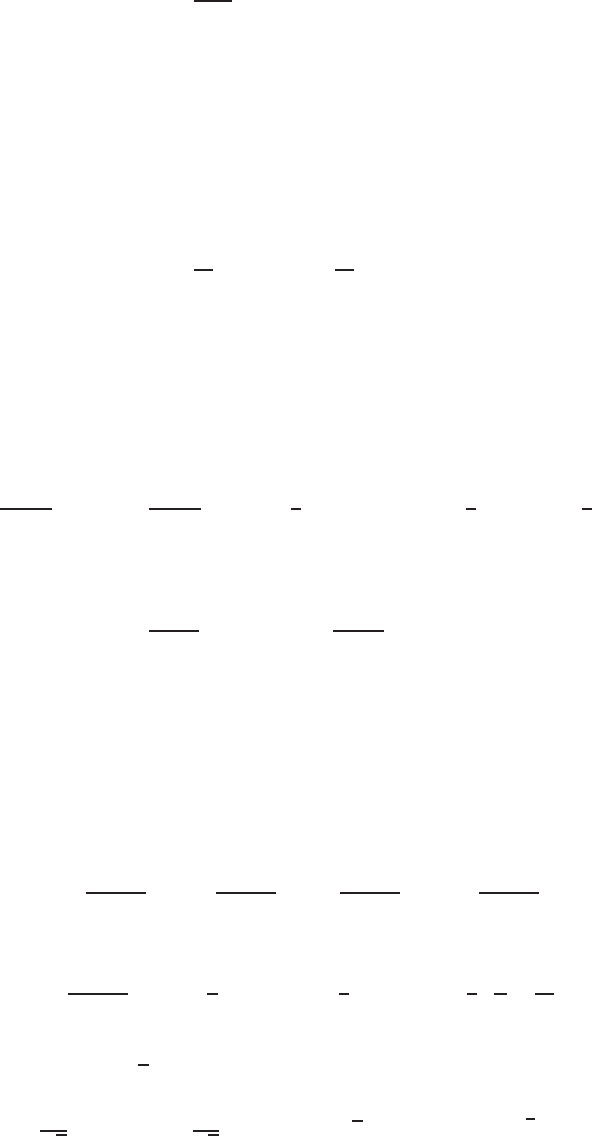
7.6 SOLUTIONS 659
10. Z∞
1
e−2xdx = lim
b→∞ Zb
1
e−2xdx = lim
b→∞ −e−2x
2
b
1
= lim
b→∞(−e−2b/2 + e−2/2) = 0 + e−2/2 = e−2/2,
where the first limit is 0 because limx→∞ e−x= 0.
11. Using integration by parts with u=xand v′=e−x, we find that
Zxe−xdx=−xe−x−Z−e−xdx =−(1 + x)e−x
so
Z∞
0
x
exdx = lim
b→∞ Zb
0
x
exdx
= lim
b→∞ −1(1 + x)e−x
b
0
=lim
b→∞ 1−(1 + b)e−b
= 1.
12. Z∞
1
x
4 + x2= lim
b→∞ Zb
1
x
4 + x2dx = lim
b→∞
1
2ln |4 + x2|
b
1
= lim
b→∞
1
2ln |4 + b2| − 1
2ln 5.
As b→ ∞,ln |4 + b2| → ∞, so the limit diverges.
13.
Z0
−∞
ex
1 + exdx = lim
b→−∞ Z0
b
ex
1 + exdx
= lim
b→−∞ ln |1 + ex|
0
b
= lim
b→−∞[ln |1 + e0| − ln |1 + eb|]
= ln(1 + 1) −ln(1 + 0) = ln 2.
14. First, we note that 1/(z2+ 25) is an even function. Therefore,
Z∞
−∞
dz
z2+ 25 =Z0
−∞
dz
z2+ 25 +Z∞
0
dz
z2+ 25 = 2 Z∞
0
dz
z2+ 25 .
We’ll now evaluate this improper integral by using a limit:
Z∞
0
dz
z2+ 25 = lim
b→∞ 1
5arctan(b/5) −1
5arctan(0)=1
5·π
2=π
10 .
So the original integral is twice that, namely π/5.
15. This integral is improper because 1/√xis undefined at x= 0. Then
Z4
0
1
√xdx = lim
b→0+Z4
b
1
√xdx = lim
b→0+ 2√x
4
b!= lim
b→0+4−2√b= 4.
The integral converges.

660 Chapter Seven /SOLUTIONS
16.
Zπ/2
π/4
sin x
√cos xdx = lim
b→π/2−Zb
π/4
sin x
√cos xdx
= lim
b→π/2−−Zb
π/4
(cos x)−1/2(−sin x)dx
= lim
b→π/2−−2(cos x)1/2
b
π/4
= lim
b→π/2−[−2(cos b)1/2+ 2(cos π/4)1/2]
= 2 √2
21
2
= 2 3
4.
17. This integral is improper because 1/v is undefined at v= 0. Then
Z1
0
1
vdv = lim
b→0+Z1
b
1
vdv = lim
b→0+ ln v
1
b!=−ln b.
As b→0+, this goes to infinity and the integral diverges.
18.
lim
a→0+Z1
a
x4+1
xdx = lim
a→0+(x4
4+ ln x)
1
a
= lim
a→0+[1/4−(a4/4 + ln a)],
which diverges as a→0, since ln a→ −∞.
19.
Z∞
1
1
x2+ 1 dx = lim
b→∞ Zb
1
1
x2+ 1 dx
= lim
b→∞ arctan(x)
b
1
= lim
b→∞[arctan(b)−arctan(1)]
=π/2−π/4 = π/4.
20.
Z∞
1
1
√x2+ 1 dx = lim
b→∞ Zb
1
1
√x2+ 1 dx
= lim
b→∞ ln |x+px2+ 1|
b
1
= lim
b→∞ ln(b+pb2+ 1) −ln(1 + √2).
As b→ ∞, this limit does not exist, so the integral diverges.
21. We use V-26 with a= 4 and b=−4:
Z4
0
−1
u2−16 du = lim
b→4−Zb
0
−1
u2−16 du
= lim
b→4−Zb
0
−1
(u−4)(u+ 4) du
= lim
b→4−−(ln |u−4| − ln |u+ 4|)
8
b
0
= lim
b→4−−1
8(ln |b−4|+ ln 4 −ln |b+ 4| − ln 4) .
As b→4−,ln |b−4| → −∞, so the limit does not exist and the integral diverges.
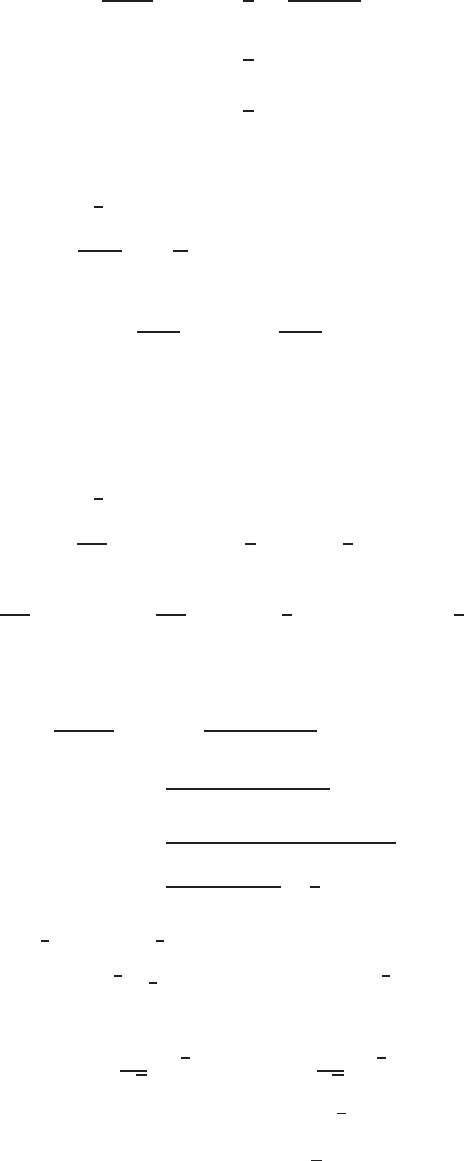
7.6 SOLUTIONS 661
22.
Z∞
1
y
y4+ 1 dy = lim
b→∞
1
2Zb
1
2y
(y2)2+ 1 dy
= lim
b→∞
1
2arctan(y2)
b
1
= lim
b→∞
1
2[arctan(b2)−arctan 1]
= (1/2)[π/2−π/4] = π/8.
23. With the substitution w= ln x,dw =1
xdx,
Zdx
xln x=Z1
wdw = ln |w|+C= ln |ln x|+C
so
Z∞
2
dx
xln x= lim
b→∞ Zb
2
dx
xln x
= lim
b→∞ ln |ln x|
b
2
= lim
b→∞[ln |ln b| − ln |ln 2|].
As b→ ∞, the limit goes to ∞and hence the integral diverges.
24. With the substitution w= ln x,dw =1
xdx,
Zln x
xdx =Zw dw =1
2w2+C=1
2(ln x)2+C
so Z1
0
ln x
xdx = lim
a→0+Z1
a
ln x
xdx = lim
a→0+
1
2[ln(x)]2
1
a
= lim
a→0+−1
2[ln(a)]2.
As a→0+,ln a→ −∞,so the integral diverges.
25. This is a proper integral; use V-26 in the integral table with a= 4 and b=−4.
Z20
16
1
y2−16 dy =Z20
16
1
(y−4)(y+ 4) dy
=ln |y−4| − ln |y+ 4|
8
20
16
=ln 16 −ln 24 −(ln 12 −ln 20)
8
=ln 320 −ln 288
8=1
8ln(10/9) = 0.01317.
26. Using the substitution w=−x1
2,−2dw =x−1
2dx,
Ze−x1
2x−1
2dx =−2Zewdw =−2e−x1
2+C.
So
Zπ
0
1
√xe−√xdx = lim
b→0+Zπ
b
1
√xe−√xdx
= lim
b→0+−2e−√x
π
b
= 2 −2e−√π.

662 Chapter Seven /SOLUTIONS
27. Letting w= ln x,dw =1
xdx,
Zdx
x(ln x)2=Zw−2dw=−w−1+C=−1
ln x+C,
so
Z∞
3
dx
x(ln x)2= lim
b→∞ Zb
3
dx
x(ln x)2
= lim
b→∞ −1
ln b+1
ln 3
=1
ln 3 .
28.
Z2
0
1
√4−x2dx = lim
b→2−Zb
0
1
√4−x2dx
= lim
b→2−arcsin x
2
b
0
= lim
b→2−arcsin b
2= arcsin 1 = π
2.
29. Z∞
4
dx
(x−1)2= lim
b→∞ Zb
4
dx
(x−1)2= lim
b→∞ −1
(x−1)
b
4
= lim
b→∞ h−1
b−1+1
3i=1
3.
30. Zdx
x2−1=Zdx
(x−1)(x+ 1) =1
2(ln |x−1| − ln |x+ 1|) + C=1
2ln |x−1|
|x+ 1|+C, so
Z∞
4
dx
x2−1= lim
b→∞ Zb
4
dx
x2−1
= lim
b→∞
1
2ln |x−1|
|x+ 1|
b
4
= lim
b→∞ h1
2ln b−1
b+ 1 −1
2ln 3
5i
=−1
2ln 3
5=1
2ln 5
3.
31.
Z∞
7
dy
√y−5= lim
b→∞ Zb
7
dy
√y−5
= lim
b→∞ 2py−5
b
7
= lim
b→∞(2√b−5−2√2).
As b→ ∞,this limit goes to ∞,so the integral diverges.
32. The integrand is undefined at y= 3.
Z3
0
ydy
p9−y2= lim
b→3−Zb
0
y
p9−y2dy = lim
b→3−−(9 −y2)1/2
b
0
=lim
b→3−3−(9−b2)1/2= 3.

7.6 SOLUTIONS 663
33. The integrand is undefined at θ= 4, so we must split the integral there.
Z6
4
dθ
(4 −θ)2= lim
a→4+Z6
a
dθ
(4 −θ)2= lim
a→4+(4 −θ)−1
6
a
=lim
a→4+1
−2−1
4−a.
Since 1/(4 −a)→ −∞ as a→4from the right, the integral does not converge. It is not necessary to check the
convergence of R4
3
dθ
(4−θ)2. However, we could have started with R4
3
dθ
(4−θ)2, instead of R6
4
dθ
(4−θ)2, and arrived at the same
conclusion.
Problems
34. We have
f(x) = Zx
−∞
etdt
= lim
a→−∞ Zx
a
etdt
= lim
a→−∞ (ex−ea)
=ex−lim
a→−∞ ea
|{z }
0
=ex.
35. (a) There is no simple antiderivative for this integrand, so we use numerical methods. We find
P(1) = 1
√πZ1
0
e−t2dt = 0.421.
(b) To calculate this improper integral, use numerical methods. If you cannot input infinity into your calculator, increase
the upper limit until the value of the integral settles down. We find
P(∞) = 1
√πZ∞
0
e−t2dt = 0.500.
36. Since the graph is above the x-axis for x≥0, we have
Area =Z∞
0
xe−xdx = lim
b→∞ Zb
0
xe−xdx
= lim
b→∞ −xe−x
b
0
+Zb
0
e−xdx
= lim
b→∞−be−b−e−x
b
0
= lim
b→∞(−be−b−e−b+e0) = 1.
37. The curve has an asymptote at t=π
2, and so the area integral is improper there.
Area =Zπ
2
0
dt
cos2t= lim
b→π
2Zb
0
dt
cos2t= lim
b→π
2
tan t
b
0
,
which diverges. Therefore the area is infinite.
38. We have:
f(3) = Z∞
0
3−tdt= lim
b→∞ Zb
0
3−tdt = lim
b→∞ −1
ln 3 3−t
b
0
= lim
b→∞ −1
ln 3 3−b−30=1
ln 3 = 0.910.
(Since lim
b→∞ 3−b= 0.)

664 Chapter Seven /SOLUTIONS
39. We have:
f(3) = Z∞
1
t−3dt = lim
b→∞ Zb
1
t−3dt = lim
b→∞ −1
2t−2
b
1
= lim
b→∞ −1
2b−2−1=1
2.
(Since lim
b→∞ b−2= 0.)
40. We have:
f(3) = Z∞
0
3e−3tdt= 3 lim
b→∞ Zb
0
e−3tdt = 3 −1
3lim
b→∞ e−3t
b
0
=−lim
b→∞ e−3b−1=−(−1) = 1.
41. We have:
f(3) = Z∞
0
2t·3e−t(3)2dt =Z∞
0
6te−9tdt = 6 lim
b→∞ Zb
0
te−9tdt.
Integration by parts with u=t, du =dt, dv =e−9tdt, v = (−1/9)e−9tgives:
Zte−9tdt=t−1
9e−9t−Z−1
9e−9tdt =−1
9te−9t−1
81 e−9t+C.
Thus:
f(3) = 6 lim
b→∞ −1
9te−9t−1
81 e−9t
b
0
= 6 0 + 1
81 =2
27 .
42. (a) We have
Z∞
0
e−y/α
αdy = lim
b→∞ −e−y/α
b
0
= lim
b→∞(1 −e−b/α) = 1.
(b) Using integration by parts with u=yand v′= (1/α)e−y/α, so u′= 1,v=−e−y/α, we have
Z∞
0
ye−y/α
αdy = lim
b→∞ Zb
0
ye−y/α
αdy
= lim
b→∞ −ye−y/α
b
0
+Zb
0
e−y/α dy!
= lim
b→∞ −be−b/α −αe−y/α
b
0!
= lim
b→∞(−be−b/α −αe−b/α +α)
Since limb→∞ −be−b/α = limb→∞ e−b/α = 0, we have
Zye−y/α
αdy =α.
(c) Using integration by parts, this time with u=y2,v′= (1/α)e−y/α, so u′= 2y,v=−e−y/α, we have
Z∞
0
y2e−y/α
αdy = lim
b→∞ Zb
0
y2e−y/α
αdy
= lim
b→∞ −y2e−y/α
b
0
+ 2 Zb
0
ye−y/α dy!
= lim
b→∞ −b2e−b/α + 2 Z∞
0
ye−y/α dy
Now limb→∞ −b2e−b/α = 0 and in part (b) we found
Z∞
0
ye−y/α
αdy =α,
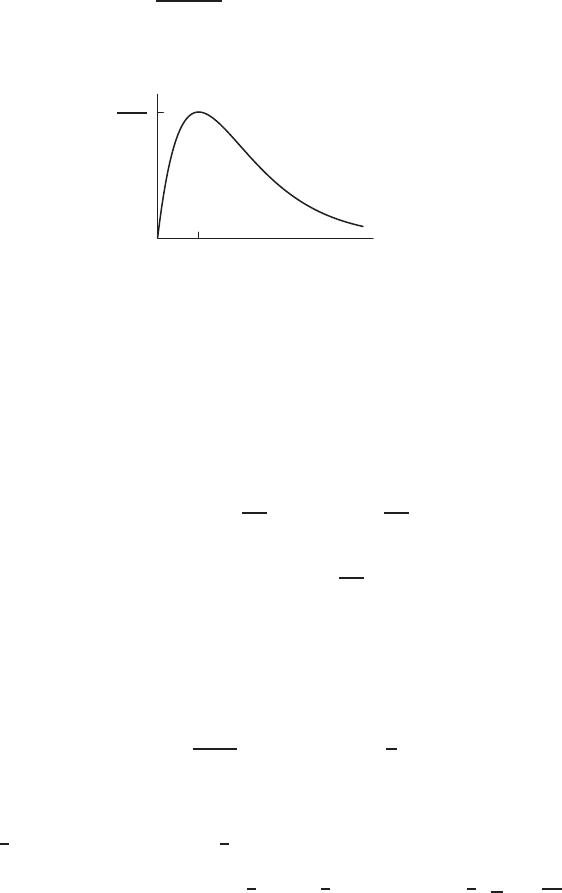
7.6 SOLUTIONS 665
so Z∞
0
ye−y/α dy =α2.
Thus, Z∞
0
y2e−y/α
αdy = 2 Z∞
0
ye−y/α dy = 2α2.
43. (a) Using a calculator or a computer, the graph is:
2
2000
e
r= 1000te−0.5t
t
r
(b) People are getting sick fastest when the rate of infection is highest, i.e. when ris at its maximum. Since
r′= 1000e−0.5t−1000(0.5)te−0.5t
= 500e−0.5t(2 −t)
this must occur at t= 2.
(c) The total number of sick people =Z∞
0
1000te−0.5tdt.
Using integration by parts, with u=t,v′=e−0.5t:
Total = lim
b→∞ 1000 −t
0.5e−0.5t
b
0−Zb
0
−1
0.5e−0.5tdt!
= lim
b→∞ 1000 −2be−0.5b−2
0.5e−0.5b
b
0
= lim
b→∞ 1000 −2be−0.5b−4e−0.5b+ 4
= 4000 people.
44. The energy required is
E=Z∞
1
kq1q2
r2dr =kq1q2lim
b→∞ −1
r
b
1
= (9 ×109)(1)(1)(1) = 9 ×109joules
45. We let t= (x−a)/√b. This means that dt =dx/√b, and that t=±∞ when x=±∞. We have
Z∞
−∞
e−(x−a)2/b dx =Z∞
−∞
e−t2(√b dt) = √bZ∞
−∞
e−t2dt =√b√π=√bπ.
46. Applying integration by parts with u=e−x2/2and v′=g′(x), so u′=−xe−x2/2and v=g(x), we have
Z∞
−∞
g′(x)e−x2/2dx =g(x)e−x2/2
∞
−∞ −Z∞
−∞ −xe−x2/2g(x)dx.
Since g(x)is bounded, limx→∞ g(x)e−x2/2=limx→−∞ g(x)e−x2/2= 0. Thus
Z∞
−∞
g′(x)e−x2/2dx =Z∞
−∞
xg(x)e−x2/2dx.

666 Chapter Seven /SOLUTIONS
47. Make the substitution w= 2x, so dw = 2 dx and x=w/2. When x= 0,w= 0 and when x→ ∞, we have w→ ∞.
We have
Z∞
0
x4e2x
(e2x−1)2dx =Z∞
0
(w/2)4ew
(ew−1)2dw/2
=1
32 Z∞
0
w4ew
(ew−1)2dw
=1
32
4π4
15 =π4
120 .
48. (a)
Γ(1) = Z∞
0
e−tdt
= lim
b→∞ Zb
0
e−tdt
= lim
b→∞ −e−t
b
0
=lim
b→∞[1 −e−b] = 1.
Using Problem 11,
Γ(2) = Z∞
0
te−tdt = 1.
(b) We integrate by parts. Let u=tn,v′=e−t. Then u′=ntn−1and v=−e−t, so
Ztne−tdt =−tne−t+nZtn−1e−tdt.
So
Γ(n+ 1) = Z∞
0
tne−tdt
= lim
b→∞ Zb
0
tne−tdt
= lim
b→∞ −tne−t
b
0
+nZb
0
tn−1e−tdt
= lim
b→∞ −bne−b+ lim
b→∞ nZb
0
tn−1e−tdt
= 0 + nZ∞
0
tn−1e−tdt
=nΓ(n).
(c) We already have Γ(1) = 1 and Γ(2) = 1. Using Γ(n+ 1) = nΓ(n)we can get
Γ(3) = 2Γ(2) = 2
Γ(4) = 3Γ(3) = 3 ·2
Γ(5) = 4Γ(4) = 4 ·3·2.
So it appears that Γ(n)is just the first n−1numbers multiplied together, so
Γ(n) = (n−1)!.
Strengthen Your Understanding
49. Let f(x) = g(x) = 1/x. Then both R∞
1f(x)dx and R∞
1g(x)dx diverge, but R∞
1f(x)g(x)dx =R∞
11/x2dx, which
converges.

7.6 SOLUTIONS 667
50. If f(x) = 1/x, then R∞
1f(x)dx diverges, but limx→∞ f(x) = 0.
51. The function f(x) = 1/x is an example. We know that limx→∞ 1/x = 0, but
Z∞
1
1
xdx = lim
b→∞ Zb
1
1
xdx = lim
b→∞(ln b−ln 1) = ∞.
Thus the improper integral diverges.
52. Since the integral is over a bounded interval, and f(x)is continuous at x= 2 and at x= 5, we need to find a function
f(x)that has a discontinuity in the interval (2,5). Let’s try f(x) = 1/(x−3)2. Because this function is discontinuous at
x= 3, we must split the improper integral R5
21/(x−3)2dx into two integrals:
Z5
2
1
(x−3)2dx =Z3
2
1
(x−3)2dx +Z5
3
1
(x−3)2dx
= lim
b→3−Zb
2
1
(x−3)2dx + lim
a→3+Z5
a
1
(x−3)2dx
= lim
b→3−−1
(b−3) +1
2−3+ lim
a→3+−1
(5 −3) +1
(a−3)
= lim
b→3−−1
(b−3) −1+ lim
a→3+1
(a−3) −1
2
Both of these limits go to ∞.Thus the improper integral R5
2f(x)dx diverges.
53. True. Since
lim
b→∞ Zb
0
f(x)dx =Za
0
f(x)dx + lim
b→∞ Zb
a
f(x)dx,
the limit on the left side of the equation is finite exactly when the limit on the right side is finite. Thus, if R∞
0f(x)dx
converges, then so does R∞
af(x)dx.
54. diverges.
True. Suppose that fhas period p. Then Rp
0f(x)dx,R2p
pf(x)dx,R3p
2pf(x)dx,. . . are all equal. If we let k=
Rp
0f(x)dx, then Rnp
0f(x)dx =nk, for any positive integer n. Since f(x)is positive, so is k. Thus as napproaches
∞, the value of Rnp
0f(x)dx =nk approaches ∞. That means that limb→∞ Rb
0f(x)dx is not finite; that is, the integral
diverges.
55. False. Let f(x) = 1/(x+ 1). Then
Z∞
0
1
x+ 1 dx = lim
b→∞ ln |x+ 1|
b
0
= lim
b→∞ ln(b+ 1),
but limb→∞ ln(b+ 1) does not exist.
56. False. Let f(x) = x+ 1. Then
Z∞
0
1
x+ 1 dx = lim
b→∞ ln |x+ 1|
b
0
= lim
b→∞ ln(b+ 1),
but limb→∞ ln(b+ 1) does not exist.
57. True. By properties of integrals and limits,
lim
b→∞ Zb
0
(f(x)+g(x)) dx = lim
b→∞ Zb
0
f(x)dx + lim
b→∞ Zb
0
g(x)dx.
Since the two limits on the right side of the equation are finite, the limit on the left side is also finite, that is,R∞
0(f(x)+g(x)) dx
converges.
58. False. For example, let f(x) = xand g(x) = −x. Then f(x) + g(x) = 0, so R∞
0(f(x) + g(x)) dx converges, even
though R∞
0f(x)dx and R∞
0g(x)dx diverge.

668 Chapter Seven /SOLUTIONS
59. True. By properties of integrals and limits,
lim
b→∞ Zb
0
af(x)dx =alim
b→∞ Zb
0
f(x)dx.
Thus, the limit on the left of the equation is finite exactly when the limit on the right side of the equation is finite. Thus
R∞
0af(x)dx converges if R∞
0f(x)dx converges.
60. True. Make the substitution w=ax. Then dw =a dx, so
Zb
0
f(ax)dx =1
aZc
0
f(w)dw,
where c=ab. As bapproaches infinity, so does c, since ais constant. Thus the limit of the left side of the equation as b
approaches infinity is finite exactly when the limit of the right side of the equation as capproaches infinity is finite. That
is, R∞
0f(ax)dx converges exactly when R∞
0f(x)dx converges.
61. True. Make the substitution w=a+x, so dw =dx. Then w=awhen x= 0, and w=a+bwhen x=b, so
Zb
0
f(a+x)dx =Zb+a
a
f(w)dw =Zc
a
f(w)dw
where c=b+a. As bapproaches infinity, so does c, since ais constant. Thus the limit of the left side of the equation as b
approaches infinity is finite exactly when the limit of the right side of the equation as capproaches infinity is finite. Since
R∞
0f(x)dxconverges, we know that limc→∞ Rc
0f(w)dw is finite, so limc→∞ Rc
af(w)dw is finite for any positive a.
Thus, R∞
0f(a+x)dx converges.
62. False. We have Zb
0
(a+f(x))dx =Zb
0
a dx +Zb
0
f(x)dx.
Since R∞
0f(x)dx converges, the second integral on the right side of the equation has a finite limit as bapproaches infinity.
But the first integral on the right side has an infinite limit as bapproaches infinity, since a6= 0. Thus the right side all
together has an infinite limit, which means that R∞
0(a+f(x)) dx diverges.
Solutions for Section 7.7
Exercises
1. For large x, the integrand behaves like 1/x2because
x2
x4+ 1 ≈x2
x4=1
x2.
Since Z∞
1
dx
x2converges, we expect our integral to converge. More precisely, since x4+ 1 > x4, we have
x2
x4+ 1 <x2
x4=1
x2.
Since Z∞
1
dx
x2is convergent, the comparison test tells us that Z∞
1
x2
x4+ 1 dx converges also.
2. For large x, the integrand behaves like 1/x because
x3
x4−1≈x3
x4=1
x.
Since Z∞
2
1
xdx does not converge, we expect our integral not to converge. More precisely, since x4−1< x4, we have
x3
x4−1>x3
x4=1
x.
Since Z∞
2
1
xdx does not converge, the comparison test tells us that Z∞
2
x3
x4−1dx does not converge either.

7.7 SOLUTIONS 669
3. The integrand is continuous for all x≥1, so whether the integral converges or diverges depends only on the behavior of
the function as x→ ∞. As x→ ∞, polynomials behave like the highest powered term. Thus, as x→ ∞, the integrand
x2+ 1
x3+ 3x+ 2 behaves like x2
x3or 1
x. Since Z∞
1
1
xdx diverges, we predict that the given integral will diverge.
4. The integrand is continuous for all x≥1, so whether the integral converges or diverges depends only on the behavior of
the function as x→ ∞. As x→ ∞, polynomials behave like the highest powered term. Thus, as x→ ∞, the integrand
1
x2+ 5x+ 1 behaves like 1
x2. Since Z∞
1
1
x2dx converges, we predict that the given integral will converge.
5. The integrand is continuous for all x≥1, so whether the integral converges or diverges depends only on the behavior of
the function as x→ ∞. As x→ ∞, polynomials behave like the highest powered term. Thus, as x→ ∞, the integrand
x
x2+ 2x+ 4 behaves like x
x2or 1
x. Since Z∞
1
1
xdx diverges, we predict that the given integral will diverge.
6. The integrand is continuous for all x≥1, so whether the integral converges or diverges depends only on the behavior of
the function as x→ ∞. As x→ ∞, polynomials behave like the highest powered term. Thus, as x→ ∞, the integrand
x2−6x+ 1
x2+ 4 behaves like x2
x2or 1. Since Z∞
1
1dxdiverges, we predict that the given integral will diverge.
7. The integrand is continuous for all x≥1, so whether the integral converges or diverges depends only on the behavior of
the function as x→ ∞. As x→ ∞, polynomials behave like the highest powered term. Thus, as x→ ∞, the integrand
5x+ 2
x4+ 8x2+ 4 behaves like 5x
x4or 5
x3. Since Z∞
1
5
x3dx converges, we predict that the given integral will converge.
8. For large t, the 2 is negligible in comparison to e5t, so the integrand behaves like e−5t. Thus
1
e5t+ 2 ≈1
e5t=e−5t.
More precisely, since e5t+ 2 > e5t, we have
1
e5t+ 2 <1
e5t=e−5t.
Since R∞
1e−5tdt converges, by the Comparison Theorem Z∞
1
1
e5t+ 2 dt converges also.
9. The integrand is continuous for all x≥1, so whether the integral converges or diverges depends only on the behavior of
the function as x→ ∞. As x→ ∞, polynomials behave like the highest powered term. Thus, as x→ ∞, the integrand
x2+ 4
x4+ 3x2+ 11 behaves like x2
x4or 1
x2. Since Z∞
1
1
x2dx converges, we predict that the given integral will converge.
10. It converges:
Z∞
50
dz
z3= lim
b→∞ Zb
50
dz
z3= lim
b→∞ −1
2z−2
b
50=1
2lim
b→∞ 1
502−1
b2=1
5000
11. Since 1
1 + x≥1
2xand 1
2Z∞
0
1
xdx diverges, we have that Z∞
1
dx
1 + xdiverges.
12. If x≥1, we know that 1
x3+ 1 ≤1
x3, and since Z∞
1
dx
x3converges, the improper integral Z∞
1
dx
x3+ 1 converges.
13. The integrand is unbounded as t→5. We substitute w=t−5, so dw =dt. When t= 5,w= 0 and when t= 8,
w= 3.Z8
5
6
√t−5dt =Z3
0
6
√wdw.
Since Z3
0
6
√wdw = lim
a→0+6Z3
a
1
√wdw = 6 lim
a→0+2w1/2
3
a
= 12 lim
a→0+(√3−√a) = 12√3,
our integral converges.
14. The integral converges.
Z1
0
1
x19/20 dx = lim
a→0Z1
a
1
x19/20 dx = lim
a→020x1/20
1
a
= lim
a→020 1−a1/20= 20.
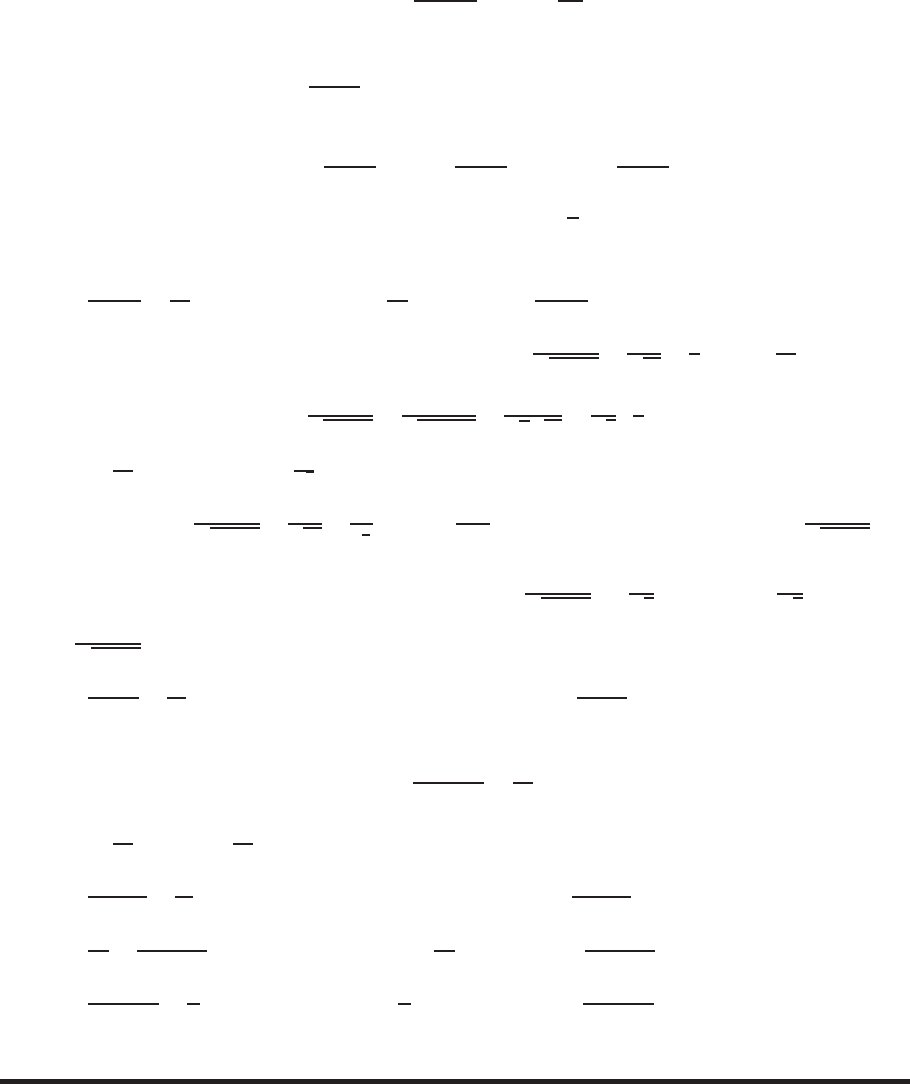
670 Chapter Seven /SOLUTIONS
15. This integral diverges. To see this, substitute t+ 1 = w,dt =dw. So,
Zt=5
t=−1
dt
(t+ 1)2=Zw=6
w=0
dw
w2,
which diverges.
16. Since we know the antiderivative of 1
1 + u2, we can use the Fundamental Theorem of Calculus to evaluate the integral.
Since the integrand is even, we write
Z∞
−∞
du
1 + u2= 2 Z∞
0
du
1 + u2= 2 lim
b→∞ Zb
0
du
1 + u2
= 2 lim
b→∞ arctan b= 2 π
2=π.
Thus, the integral converges to π.
17. Since 1
u+u2<1
u2for u≥1, and since Z∞
1
du
u2converges, Z∞
1
du
u+u2converges.
18. This improper integral diverges. We expect this because, for large θ,1
√θ2+ 1 ≈1
√θ2=1
θand Z∞
1
dθ
θdiverges. More
precisely, for θ≥11
√θ2+ 1 ≥1
√θ2+θ2=1
√2√θ2=1
√2·1
θ
and Z∞
1
dθ
θdiverges. (The factor 1
√2does not affect the divergence.)
19. For θ≥2, we have 1
√θ3+ 1 ≤1
√θ3=1
θ3
2
, and Z∞
2
dθ
θ3/2converges (check by integration), so Z∞
2
dθ
√θ3+ 1 con-
verges.
20. This integral is improper at θ= 0. For 0≤θ≤1, we have 1
√θ3+θ≤1
√θ, and since Z1
0
1
√θdθ converges,
Z1
0
dθ
√θ3+θconverges.
21. Since 1
1 + ey≤1
ey=e−yand Z∞
0
e−ydyconverges, the integral Z∞
0
dy
1 + eyconverges.
22. This integral is convergent because, for φ≥1,
2 + cos φ
φ2≤3
φ2,
and Z∞
1
3
φ2dφ = 3 Z∞
1
1
φ2dφ converges.
23. Since 1
ez+ 2z<1
ez=e−zfor z≥0, and Z∞
0
e−zdz converges, Z∞
0
dz
ez+ 2zconverges.
24. Since 1
φ2≤2−sin φ
φ2for 0< φ ≤π, and since Zπ
0
1
φ2dφ diverges, Zπ
0
2−sin φ
φ2dφ must diverge.
25. Since 3 + sin α
α≥2
αfor α≥4, and since Z∞
4
2
αdα diverges, then Z∞
4
3 + sin α
αdα diverges.
Problems
26. (a) The area is infinite. The area under 1/x is infinite and the area under 1/x2is 1. So the area between the two has to
be infinite also.
(b) Since f(x)is bounded between 0 and 1/x2, and the area under 1/x2is finite, f(x)will have finite area by the
comparison test. Similarly, h(x)lies above 1/x, whose area is infinite, so h(x)must have infinite area as well. We
can tell nothing about the area of g(x), because the comparison test tells us nothing about a function larger than a
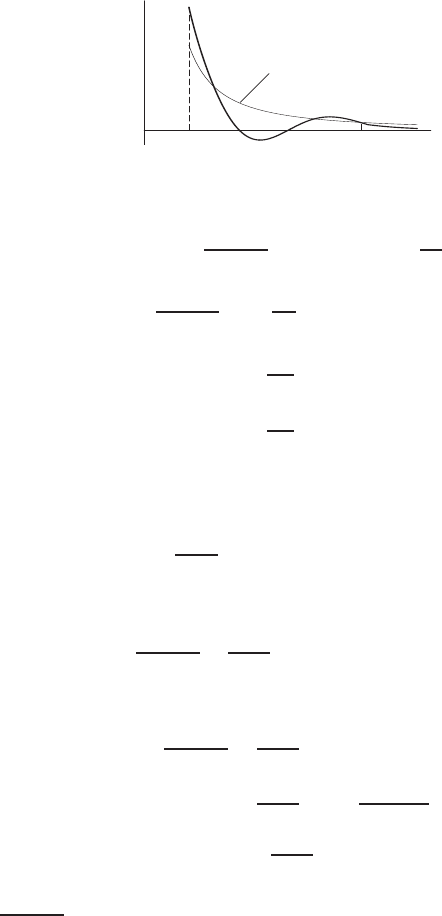
7.7 SOLUTIONS 671
function with finite area but smaller than one with infinite area. Finally, k(x)will certainly have infinite area, because
it has a lower bound m, for some m > 0. Thus, Ra
0k(x)dx ≥ma, and since the latter does not converge as a→ ∞,
neither can the former.
27. The convergence or divergence of an improper integral depends on the long-term behavior of the integrand, not on its
short-term behavior. Figure 7.46 suggests that g(x)≤f(x)for all values of xbeyond x=k. Since R∞
kf(x)dx
converges, we expect R∞
kg(x)dx converges also.
However we are interested in R∞
ag(x)dx. Breaking the integral into two parts enables us to use the fact that
R∞
kg(x)dx is finite:
Z∞
a
g(x)dx =Zk
a
g(x)dx +Z∞
k
g(x)dx.
The first integral is also finite because the interval from ato kis finite. Therefore, we expect R∞
ag(x)dxconverges.
ak
✠
f(x)
g(x)
x
Figure 7.46
28. First let’s calculate the indefinite integral Zdx
x(ln x)p. Let ln x=w, then dx
x=dw. So
Zdx
x(ln x)p=Zdw
wp
=ln |w|+C, if p= 1
1
1−pw1−p+C, if p6= 1
=ln |ln x|+C, if p= 1
1
1−p(ln x)1−p+C, if p6= 1.
Notice that lim
x→∞ ln x= +∞.
(a) p= 1:
Z∞
2
dx
xln x= lim
b→∞ ln |lnb| − ln |ln 2|= +∞.
(b) p < 1:
Z∞
2
dx
x(ln x)p=1
1−plim
b→∞(ln b)1−p−(ln 2)1−p= +∞.
(c) p > 1:
Z∞
2
dx
x(ln x)p=1
1−plim
b→∞(ln b)1−p−(ln 2)1−p
=1
1−plim
b→∞
1
(ln b)p−1−(ln 2)1−p
=−1
1−p(ln 2)1−p.
Thus, Z∞
2
dx
x(ln x)pis convergent for p > 1, divergent for p≤1.

672 Chapter Seven /SOLUTIONS
29. The indefinite integral Zdx
x(ln x)pis computed in Problem 28. Let ln x=w, then dx
x=dw. Notice that lim
x→1ln x= 0,
and lim
x→0+ln x=−∞.
For this integral notice that ln 1 = 0, so the integrand blows up at x= 1.
(a) p= 1:
Z2
1
dx
xln x= lim
a→1+(ln |ln 2| − ln |ln a|)
Since ln a→0as a→1,ln |ln a| → −∞ as b→1. So the integral is divergent.
(b) p < 1:
Z2
1
dx
x(ln x)p=1
1−plim
a→1+(ln 2)1−p−(ln a)1−p
=1
1−p(ln 2)1−p.
(c) p > 1:
Z2
1
dx
x(ln x)p=1
1−plim
a→1+(ln 2)1−p−(ln a)1−p
As lim
a→1+(ln a)1−p= lim
a→1+
1
(ln a)p−1= +∞, the integral diverges.
Thus, Z2
1
dx
x(ln x)pis convergent for p < 1, divergent for p≥1.
30. (a) Since e−x2≤e−3xfor x≥3,Z∞
3
e−x2dx ≤Z∞
3
e−3xdx
Now
Z∞
3
e−3xdx= lim
b→∞ Zb
3
e−3xdx = lim
b→∞ −1
3e−3x
b
3
= lim
b→∞
e−9
3−e−3b
3=e−9
3.
Thus Z∞
3
e−x2dx ≤e−9
3.
(b) By reasoning similar to part (a), Z∞
n
e−x2dx ≤Z∞
n
e−nx dx,
and Z∞
n
e−nx dx =1
ne−n2,
so Z∞
n
e−x2dx ≤1
ne−n2.
31. (a) The tangent line to ethas slope (et)′=et. Thus at t= 0, the slope is e0= 1. The line passes through (0, e0) =
(0,1). Thus the equation of the tangent line is y= 1 + t. Since etis everywhere concave up, its graph is always
above the graph of any of its tangent lines; in particular, etis always above the line y= 1 + t. This is tantamount to
saying
1 + t≤et,
with equality holding only at the point of tangency, t= 0.

7.7 SOLUTIONS 673
(b) If t=1
x, then the above inequality becomes
1 + 1
x≤e1/x,or e1/x −1≥1
x.
Since t=1
x,tis never zero. Therefore, the inequality is strict, and we write
e1/x −1>1
x.
(c) Since e1/x −1>1
x,
1
x5(e1/x −1) <1
x51
x=1
x4.
Since Z∞
1
dx
x4converges, Z∞
1
dx
x5(e1/x −1) converges.
Strengthen Your Understanding
32. We cannot compare the integrals, because the first integrand is sometimes less than the second and sometimes greater than
the second, depending on the sign of sin x.
33. We can use the comparison test with 1
x√2. Since x > 0, we have
0<1
x√2+ 1 <1
x√2,
and Z∞
1
1
x√2dx is convergent (p=√2>1), the original integral, Z∞
1
1
x√2+ 1 dx, converges.
34. The integral Z∞
0
f(x)dx might converge or diverge; the comparison test can not be used here.
35. Let f(x) = 1
x2. Then Z∞
1
1
x2dx converges. However Z∞
1
1
f(x)dx =Z∞
1
x2dx diverges.
36. We know that the integral R∞
13/(2x2)dx converges because
Z∞
1
3
2x2dx = lim
b→∞ Zb
1
3
2x2dx = lim
b→∞ −3
2b+3
2=3
2.
So we know that if f(x)is positive and f(x)≤3/(2x2)for all x≥1, then R∞
1f(x)dx converges. So the function
f(x) = 3/(2x2+ 1) is a good example.
37. Since −1≤sin x≤1for all x, we know that, for all x,
7x−2≤7x−2 sin x≤7x+ 2.
So since 7x−2 sin x≥0for all x≥1, we know that for all x≥1,
3
7x−2 sin x≥3
7x+ 2 .
So let
f(x) = 3
7x+ 2 .
We then have Z∞
1
f(x)dx = lim
b→∞ Zb
1
3
7x+ 2 dx = lim
b→∞ 3
7ln |7b+ 2| − 3
7ln 9=∞
So the integral R∞
1f(x)dx diverges, as desired.
38. True. Since 1
ex+x<1
exand Z∞
0
1
exdx converges, Z∞
0
dx
ex+xconverges.
39. True. Since 1
x2−3>1
x2and Z1
0
dx
x2diverges, Z1
0
dx
x2−3diverges.

674 Chapter Seven /SOLUTIONS
Solutions for Chapter 7 Review
Exercises
1. 1
3(t+ 1)3
2. −cos 2θ
3. 5x
ln 5
4. et+ 5 1
5e5t=et+e5t
5. Using the power rule gives 3
2w2+ 7w+C.
6. 1
2e2r+C
7. Since d
dt cos t=−sin t, we have
Zsin t dt =−cos t+C, where Cis a constant.
8. Let 2t=w, then 2dt =dw, so dt =1
2dw, so
Zcos 2tdt =Z1
2cos w dw =1
2sin w+C=1
2sin 2t+C,
where Cis a constant.
9. Let 5z=w, then 5dz =dw, which means dz =1
5dw, so
Ze5zdz=Zew·1
5dw =1
5Zewdw =1
5ew+C=1
5e5z+C,
where Cis a constant.
10. sin(x+ 1) + C
11. Since Zsin w dθ =−cos w+C, the substitution w= 2θ,dw = 2 dθ gives Zsin 2θ dθ =−1
2cos 2θ+C.
12. Let w=x3−1, then dw = 3x2dx so that
Z(x3−1)4x2dx =1
3Zw4dw =1
15 w5+C=1
15 (x3−1)5+C.
13. The power rule gives 2
5x5/2+3
5x5/3+C
14. From the rule for antidifferentiation of exponentials, we get
Z(ex+ 3x)dx =ex+1
ln 3 ·3x+C.
15. Z1
ezdz =Ze−zdz =−e−z+C
16. Rewrite the integrand as
Z4
x2−3
x3dx = 4 Zx−2dx −3Zx−3dx =−4x−1+3
2x−2+C.
17. Dividing by x2gives
Zx3+x+1
x2dx =Zx+1
x+1
x2dx =1
2x2+ ln |x| − 1
x+C.

SOLUTIONS to Review Problems for Chapter Seven 675
18. Let w= 1 + ln x, then dw =dx/x so that
Z(1 + ln x)2
xdx =Zw2dw =1
3w3+C=1
3(1 + ln x)3+C.
19. Substitute w=t2, so dw = 2t dt.
Ztet2dt =1
2Zet22t dt =1
2Zewdw =1
2ew+C=1
2et2+C.
Check: d
dt 1
2et2+C= 2t1
2et2=tet2.
20. Integration by parts with u=x,v′= cos xgives
Zxcos x dx =xsin x−Zsin x dx +C=xsin x+ cos x+C.
Or use III-16 with p(x) = xand a= 1 in the integral table.
21. Integration by parts twice gives
Zx2e2xdx=x2e2x
2−Z2xe2xdx =x2
2e2x−x
2e2x+1
4e2x+C
= ( 1
2x2−1
2x+1
4)e2x+C.
Or use the integral table, III-14 with p(x) = x2and a= 1.
22. Using substitution with w= 1 −xand dw =−dx, we get
Zx√1−x dx =−Z(1 −w)√wdw =2
5w5/2−2
3w3/2+C=2
5(1 −x)5/2−2
3(1 −x)3/2+C.
23. Let u= ln y,v′=y. Then, v=1
2y2and u′=1
y. Integrating by parts, we get:
Zyln y dy =1
2y2ln y−Z1
2y2·1
ydy
=1
2y2ln y−1
2Zy dy
=1
2y2ln y−1
4y2+C.
24. We integrate by parts, with u=y,v′= sin y. We have u′= 1,v=−cos y, and
Zysin y dy =−ycos y−Z(−cos y)dy =−ycos y+ sin y+C.
Check: d
dy (−ycos y+ sin y+C) = −cos y+ysin y+ cos y=ysin y.
25. We integrate by parts, using u= (ln x)2and v′= 1. Then u′= 2 ln x
xand v=x, so
Z(ln x)2dx =x(ln x)2−2Zln x dx.
But, integrating by parts or using the integral table, Rln x dx =xln x−x+C. Therefore,
Z(ln x)2dx=x(ln x)2−2xln x+ 2x+C.
Check: d
dx x(ln x)2−2xln x+ 2x+C= (ln x)2+x2 ln x
x−2 ln x−2x1
x+ 2 = (ln x)2.

676 Chapter Seven /SOLUTIONS
26. Using the exponent rules and the chain rule, we have
Ze0.5−0.3tdt =e0.5Ze−0.3tdt =−e0.5
0.3e−0.3t+C=−e0.5−0.3t
0.3+C.
27. Let sin θ=w, then cos θ dθ =dw, so
Zsin2θcos θ dθ =Zw2dw =1
3w3+C=1
3sin3θ+C,
where Cis a constant.
28. Substitute w= 4 −x2,dw =−2x dx:
Zxp4−x2dx =−1
2Z√w dw =−1
3w3/2+C=−1
3(4 −x2)3/2+C.
Check d
dx h−1
3(4 −x2)3/2+Ci=−1
3h3
2(4 −x2)1/2(−2x)i=xp4−x2.
29. Expanding the numerator and dividing, we have
Z(u+ 1)3
u2du =Z(u3+3u2+ 3u+ 1)
u2du =Zu+ 3 + 3
u+1
u2du
=u2
2+ 3u+ 3 ln |u| − 1
u+C.
Check:
d
du u2
2+ 3u+ 3 ln |u| − 1
u+C=u+ 3 + 3/u + 1/u2=(u+ 1)3
u2.
30. Substitute w=√y,dw = 1/(2√y)dy. Then
Zcos √y
√ydy = 2 Zcos w dw = 2 sin w+C= 2 sin √y+C.
Check: d
dy 2 sin √y+C=2 cos √y
2√y=cos √y
√y.
31. Since d
dz (tan z) = 1
cos2z, we have
Z1
cos2zdz = tan z+C.
Check: d
dz (tan z+C) = d
dz
sin z
cos z=(cos z)(cos z)−(sin z)(−sin z)
cos2z=1
cos2z.
32. Denote Zcos2θdθ by A. Let u= cos θ,v′= cos θ. Then, v= sin θand u′=−sin θ. Integrating by parts, we get:
A= cos θsin θ−Z(−sin θ) sin θ dθ.
Employing the identity sin2θ= 1 −cos2θ, the equation above becomes:
A= cos θsin θ+Zdθ −Zcos2θdθ
= cos θsin θ+θ−A+C.

SOLUTIONS to Review Problems for Chapter Seven 677
Solving this equation for A, and using the identity sin 2θ= 2 cos θsin θwe get:
A=Zcos2θ dθ =1
4sin 2θ+1
2θ+C.
[Note: An alternate solution would have been to use the identity cos2θ=1
2cos 2θ+1
2.]
33. Multiplying out and integrating term by term:
Zt10(t−10) dt =Z(t11 −10t10)dt =Zt11dt −10 Zt10 dt =1
12 t12 −10
11 t11 +C.
34. Substitute w= 2x−6. Then dw = 2 dx and
Ztan(2x−6)dx =1
2Ztan w dw =1
2Zsin w
cos wdw
=−1
2ln |cos w|+Cby substitution or by I-7 of the integral table.
=−1
2ln |cos(2x−6)|+C.
35. Let ln x=w, then 1
xdx =dw, so
Z(ln x)2
xdx =Zw2dw =1
3w3+C=1
3(ln x)3+C, where Cis a constant.
36. Multiplying out, dividing, and then integrating yields
Z(t+2)2
t3dt =Zt2+ 4t+ 4
t3dt =Z1
tdt +Z4
t2dt +Z4
t3dt = ln |t| − 4
t−2
t2+C,
where Cis a constant.
37. Integrating term by term: Zx2+ 2x+1
xdx =1
3x3+x2+ ln |x|+C,
where Cis a constant.
38. Dividing and then integrating, we obtain
Zt+ 1
t2dt =Z1
tdt +Z1
t2dt = ln |t| − 1
t+C, where Cis a constant.
39. Let t2+ 1 = w, then 2t dt =dw, tdt =1
2dw, so
Ztet2+1 dt =Zew·1
2dw =1
2Zewdw =1
2ew+C=1
2et2+1 +C,
where Cis a constant.
40. Let cos θ=w, then −sin θ dθ =dw, so
Ztan θdθ =Zsin θ
cos θdθ =Z−1
wdw
=−ln |w|+C=−ln |cos θ|+C,
where Cis a constant.
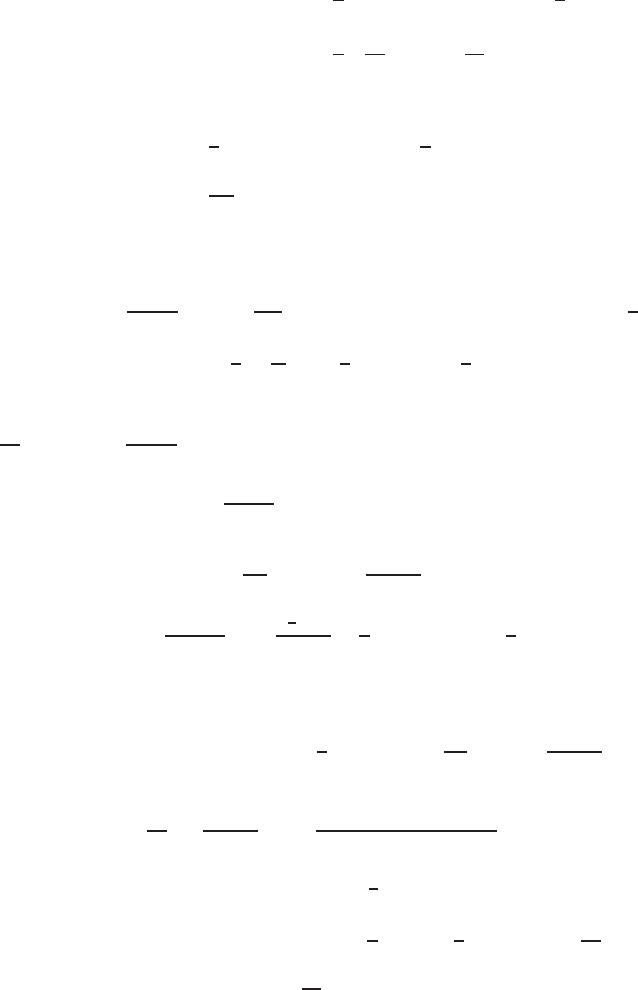
678 Chapter Seven /SOLUTIONS
41. If u= sin(5θ),du = cos(5θ)·5dθ, so
Zsin(5θ) cos(5θ)dθ =1
5Zsin(5θ)·5cos(5θ)dθ =1
5Zu du
=1
5u2
2+C=1
10 sin2(5θ) + C
or
Zsin(5θ)cos(5θ)dθ =1
2Z2 sin(5θ) cos(5θ)dθ =1
2Zsin(10θ)dθ (using sin(2x) = 2 sin xcos x)
=−1
20 cos(10θ) + C.
42. Using substitution,
Zx
x2+ 1 dx =Z1/2
wdw (x2+ 1 = w, 2x dx =dw, xdx =1
2dw)
=1
2Z1
wdw =1
2ln |w|+C=1
2ln |x2+ 1|+C,
where Cis a constant.
43. Since d
dz (arctan z) = 1
1 + z2, we have
Zdz
1 + z2= arctan z+C, where Cis a constant.
44. Let w= 2z, so dw = 2dz. Then, since d
dw arctan w=1
1 + w2, we have
Zdz
1 + 4z2=Z1
2dw
1 + w2=1
2arctan w+C=1
2arctan 2z+C.
45. Let w= cos 2θ. Then dw =−2 sin 2θ dθ, hence
Zcos32θsin 2θ dθ =−1
2Zw3dw =−w4
8+C=−cos42θ
8+C.
Check:
d
dθ −cos42θ
8=−(4 cos32θ)(−sin 2θ)(2)
8= cos32θsin 2θ.
46. Let cos 5θ=w, then −5 sin 5θ dθ =dw, sin 5θ dθ =−1
5dw. So
Zsin 5θcos35θ dθ =Zw3·(−1
5)dw =−1
5Zw3dw=−1
20 w4+C
=−1
20 cos45θ+C,
where Cis a constant.
47.
Zsin3zcos3z dz =Zsin z(1 −cos2z) cos3z dz
=Zsin zcos3z dz −Zsin zcos5z dz

SOLUTIONS to Review Problems for Chapter Seven 679
=Zw3(−dw)−Zw5(−dw) (let cos z=w, so −sin z dz =dw)
=−Zw3dw+Zw5dw
=−1
4w4+1
6w6+C
=−1
4cos4z+1
6cos6z+C,
where Cis a constant.
48. If u=t−10,t=u+ 10 and dt = 1 du, so substituting we get
Z(u+10)u10du =Z(u11 + 10u10)du =1
12 u12 +10
11 u11 +C
=1
12 (t−10)12 +10
11 (t−10)11 +C.
49. Let sin θ=w, then cos θ dθ =dw, so
Zcos θ√1 + sin θ dθ =Z√1 + w dw
=(1 + w)3/2
3/2+C=2
3(1 + sin θ)3/2+C,
where Cis a constant.
50.
Zxexdx=xex−Zexdx (let x=u, ex=v′, ex=v)
=xex−ex+C,
where Cis a constant.
51.
Zt3etdt=t3et−Z3t2etdt (let t3=u, et=v′,3t2=u′, et=v)
=t3et−3Zt2etdt (let t2=u, et=v′)
=t3et−3(t2et−Z2tetdt)
=t3et−3t2et+ 6 Ztetdt(let t=u, et=v′)
=t3et−3t2et+ 6(tet−Zetdt)
=t3et−3t2et+ 6tet−6et+C,
where Cis a constant.
52. Let x2=w, then 2xdx =dw,x= 1 ⇒w= 1,x= 3 ⇒w= 9. Thus,
Z3
1
x(x2+1)70 dx =Z9
1
(w+ 1)70 1
2dw
=1
2·1
71 (w+ 1)71
9
1
=1
142 (1071 −271).

680 Chapter Seven /SOLUTIONS
53. Let w= 3z+ 5 and dw = 3 dz. Then
Z(3z+ 5)3dz =1
3Zw3dw =1
12 w4+C=1
12 (3z+ 5)4+C.
54. Rewrite 9 + u2as 9[1 + (u/3)2]and let w=u/3,then dw =du/3so that
Zdu
9 + u2=1
3Zdw
1 + w2=1
3arctan w+C=1
3arctan u
3+C.
55. Let u= sin w, then du = cos w dw so that
Zcos w
1 + sin2wdw =Zdu
1 + u2= arctan u+C= arctan(sin w) + C.
56. Let w= ln x, then dw = (1/x)dx which gives
Z1
xtan(ln x)dx =Ztan w dw =Zsin w
cos wdw =−ln(|cos w|) + C=−ln(|cos(ln x)|) + C.
57. Let w= ln x, then dw = (1/x)dx so that
Z1
xsin(ln x)dx =Zsin w dw =−cos w+C=−cos(ln x) + C.
58. Let u= 16 −w2,then du =−2w dw so that
Zwdw
√16 −w2=−1
2Zdu
√u=−√u+C=−p16 −w2+C.
59. Dividing and then integrating term by term, we get
Ze2y+1
e2ydy =Ze2y
e2y+1
e2ydy =Z(1 + e−2y)dy =Zdy +−1
2Ze−2y(−2) dy
=y−1
2e−2y+C.
60. Let u= 1 −cos w, then du = sin w dw which gives
Zsin w dw
√1−cos w=Zdu
√u= 2√u+C= 2√1−cos w+C.
61. Let w= ln x. Then dw = (1/x)dx which gives
Zdx
xln x=Zdw
w= ln |w|+C= ln |ln x|+C.
62. Let w= 3u+ 8, then dw = 3du and
Zdu
3u+ 8 =Zdw
3w=1
3ln |3u+ 8|+C.
63. Let w=√x2+ 1,then dw =xdx
√x2+ 1 so that
Zx
√x2+ 1 cos px2+ 1 dx =Zcos w dw = sin w+C= sin px2+ 1 + C.

SOLUTIONS to Review Problems for Chapter Seven 681
64. Integrating by parts using u=t2and dv =tdt
√1+t2gives du = 2t dt and v=√1 + t2.Now
Zt3
√1 + t2dt =t2p1 + t2−Z2tp1 + t2dt
=t2p1 + t2−2
3(1 + t2)3/2+C
=p1 + t2(t2−2
3(1 + t2)) + C
=p1 + t2(t2−2)
3+C.
65. Using integration by parts, let r=uand dt =ekudu, so dr =du and t= (1/k)eku .Thus
Zueku du =u
keku −1
kZekudu =u
keku −1
k2eku +C.
66. Let u=w+ 5, then du =dw and noting that w=u−5we obtain
Z(w+ 5)4w dw =Zu4(u−5) du
=Zu5−5u4du
=1
6u6−u5+C
=1
6(w+ 5)6−(w+ 5)5+C.
67. Ze√2x+3dx =1
√2Ze√2x+3√2dx. If u=√2x+ 3,du =√2dx, so
1
√2Zeudu =1
√2eu+C=1
√2e√2x+3 +C.
68. Z(ex+x)2dx=Z(e2x+ 2xex+x2)dy. Separating into three integrals, we have
Ze2xdx =1
2Ze2x2dx =1
2e2x+C1,
Z2xexdx = 2 Zxexdx = 2xex−2ex+C2
from Formula II-13 of the integral table or integration by parts, and
Zx2dx =x3
3+C3.
Combining the results and writing C=C1+C2+C3,we get
1
2e2x+ 2xex−2ex+x3
3+C.
69. Integrate by parts, r= ln uand dt =u2du, so dr = (1/u)du and t= (1/3)u3. We have
Zu2lnu du =1
3u3ln u−1
3Zu2du =1
3u3ln u−1
9u3+C.

682 Chapter Seven /SOLUTIONS
70. The integral table yields
Z5x+ 6
x2+ 4 dx =5
2ln |x2+ 4|+6
2arctan x
2+C
=5
2ln |x2+ 4|+ 3 arctan x
2+C.
Check:
d
dx 5
2ln |x2+ 4|+6
2arctan x
2+C=5
21
x2+ 4 (2x) + 3 1
1 + (x/2)2
1
2
=5x
x2+ 4 +6
x2+ 4 =5x+ 6
x2+ 4 .
71. Using Table IV-19, let m= 3, w = 2x, and dw = 2dx. Then
Z1
sin3(2x)dx =1
2Z1
sin3wdw
=1
2−1
(3 −1)
cos w
sin2w+1
4Z1
sin wdw,
and using Table IV-20, we have Z1
sin wdw =1
2ln
cos w−1
cos w+ 1 +C.
Thus, Z1
sin3(2x)dx =−cos 2x
4 sin22x+1
8ln
cos 2x−1
cos 2x+ 1 +C.
72. We can factor r2−100 = (r−10)(r+ 10) so we can use Table V-26 (with a= 10 and b=−10) to get
Zdr
r2−100 =1
20 [ln |r−10|+ ln |r+ 10|] + C.
73. Integration by parts will be used twice here. First let u=y2and dv = sin(cy)dy, then du = 2y dy and v=
−(1/c) cos(cy).Thus Zy2sin(cy)dy =−y2
ccos(cy) + 2
cZycos(cy)dy.
Now use integration by parts to evaluate the integral in the right hand expression. Here let u=yand dv = cos(cy)dy
which gives du =dy and v= (1/c) sin(cy).Then we have
Zy2sin(cy)dy =−y2
ccos(cy) + 2
cy
csin(cy)−1
cZsin(cy)dy
=−y2
ccos(cy) + 2y
c2sin(cy) + 2
c3cos(cy) + C.
74. Integration by parts will be used twice. First let u=e−ct and dv = sin(kt)dt, then du =−ce−ctdt and v=
(−1/k) cos kt. Then
Ze−ctsin kt dt =−1
ke−ct cos kt −c
kZe−ct cos kt dt
=−1
ke−ct cos kt −c
k1
ke−ct sin kt +c
kZe−ct sin kt dt
=−1
ke−ct cos kt −c
k2e−ct sin kt −c2
k2Ze−ct sin kt dt

SOLUTIONS to Review Problems for Chapter Seven 683
Solving for Re−ct sin kt dt gives
k2+c2
k2Ze−ctsin kt dt =−e−ct
k2(kcos kt +csin kt),
so Ze−ct sin kt dt =−e−ct
k2+c2(kcos kt +csin kt) + C.
75. Using II-9 from the integral table, with a= 5 and b= 3, we have
Ze5xcos(3x)dx =1
25 + 9 e5x[5 cos(3x) + 3 sin(3x)] + C
=1
34 e5x[5 cos(3x) + 3 sin(3x)] + C.
76. Since Z(x√k+ (√k)x)dx =Zx√kdx +Z(√k)xdx, for the first integral, use Formula I-1 with n=√k. For the
second integral, use Formula I-3 with a=√k. The result is
Z(x√x+ (√k)x)dx =x(√k)+1
(√k) + 1 +(√k)x
ln √k+C.
77. Factor √3out of the integrand and use VI-30 of the integral table with u= 2xand du = 2dx to get
Zp3 + 12x2dx =Z√3p1 + 4x2dx
=√3
2Zp1 + u2du
=√3
4up1 + u2+Z1
√1 + u2du.
Then from VI-29, simplify the integral on the right to get
Zp3 + 12x2dx =√3
4up1 + u2+ ln |u+p1 + u2|+C
=√3
42xp1 + (2x)2+ ln |2x+p1 + (2x)2|+C.
78. By completing the square, we get
x2−3x+ 2 = (x2−3x+ (−3
2)2) + 2 −9
4= (x−3
2)2−1
4.
Then Z1
√x2−3x+ 2 dx =Z1
p(x−3
2)2−1
4
dx.
Let w= (x−(3/2)), then dw =dx and a2= 1/4.Then we have
Z1
√x2−3x+ 2 dx =Z1
√w2−a2dw
and from VI-29 of the integral table we have
Z1
√w2−a2dw = ln w+pw2−a2+C
= ln x−3
2+rx−3
22
−1
4
+C
= ln x−3
2+px2−3x+ 2+C.

684 Chapter Seven /SOLUTIONS
79. First divide x2+ 3x+ 2 into x3to obtain
x3
x2+ 3x+ 2 =x−3 + 7x+ 6
x2+ 3x+ 2 .
Since x2+ 3x+ 2 = (x+ 1)(x+ 2), we can use V-27 of the integral table (with c= 7,d= 6,a=−1, and b=−2) to
get Z7x+ 6
x2+ 3x+ 2 dx =−ln |x+ 1|+ 8 ln |x+ 2|+C.
Including the terms x−3from the long division and integrating them gives
Zx3
x2+ 3x+ 2 dx =Zx−3 + 7x+ 6
x2+ 3x+ 6 dx =1
2x2−3x−ln |x+ 1|+ 8 ln |x+ 2|+C.
80. First divide x2+ 1 by x2−3x+ 2 to obtain
x2+ 1
x2−3x+ 2 = 1 + 3x−1
x2−3x+ 2 .
Factoring x2−3x+ 2 = (x−2)(x−1) we can use V-27 (with c= 3,d=−1,a= 2 and b= 1) to write
Z3x−1
x2−3x+ 2 dx = 5 ln |x−2| − 2 ln |x−1|+C.
Remembering to include the extra term of +1 we got when dividing, we get
Zx2+1
x2−3x+ 2 dx =Z1 + 3x−1
x2−3x+ 2 dx =x+ 5 ln |x−2| − 2 ln |x−1|+C.
81. We can factor the denominator into ax(x+b
a), so
Zdx
ax2+bx =1
aZ1
x(x+b
a)
Now we can use V-26 (with A= 0 and B=−b
ato give
1
aZ1
x(x+b
a)=1
a·a
bln |x| − ln x+b
a+C=1
bln |x| − ln x+b
a+C.
82. Let w=ax2+ 2bx +c, then dw = (2ax + 2b)dx so that
Zax +b
ax2+ 2bx +cdx =1
2Zdw
w=1
2ln |w|+C=1
2ln |ax2+ 2bx +c|+C.
83. Multiplying out and integrating term by term,
Zx
3+3
x2
dx =Zx2
9+ 2 + 9
x2dx =1
9x3
3+ 2x+ 9 x−1
−1+C=x3
27 + 2x−9
x+C.
84. If u= 2t+ 1,du = 2t(ln 2) dt, so
Z2t
2t+ 1 dt =1
ln 2 Z2tln 2
2t+ 1 dt =1
ln 2 Z1
u=1
ln 2 ln |u|+C=1
ln 2 ln |2t+ 1|+C.
85. If u= 1 −x,du =−1dx, so
Z101−xdx=−1Z101−x(−1dx) = −1Z10udu =−110u
ln 10 +C=−1
ln 10 101−x+C.

SOLUTIONS to Review Problems for Chapter Seven 685
86. Multiplying out and integrating term by term gives
Z(x2+ 5)3dx =Z(x6+ 15x4+ 75x2+ 125)dx =1
7x7+ 15 x5
5+ 75 x3
3+ 125x+C
=1
7x7+ 3x5+ 25x3+ 125x+C.
87. Integrate by parts letting r=vand dt = arcsin v dv then dr =dv and to find twe integrate arcsin v dv by parts letting
x= arcsin vand dy =dv. This gives
t=varcsin v−Z(1/p1−v2)v dv =varcsin v+p1−v2.
Now, back to the original integration by parts, and we have
Zvarcsin v dv =v2arcsin v+vp1−v2−Zhvarcsin v+p1−v2idv.
Adding Rvarcsin v dv to both sides of the above line we obtain
2Zvarcsin v dv =v2arcsin v+vp1−v2−Zp1−v2dv
=v2arcsin v+vp1−v2−1
2vp1−v2−1
2arcsin v+C.
Dividing by 2 gives Zvarcsin v dv =v2
2−1
4arcsin v+1
4vp1−v2+K,
where K=C/2.
88. By VI-30 in the table of integrals, we have
Zp4−x2dx =x√4−x2
2+ 2 Z1
√4−x2dx.
The same table informs us in formula VI-28 that
Z1
√4−x2dx = arcsin x
2+C.
Thus Zp4−x2dx =x√4−x2
2+ 2 arcsin x
2+C.
89. By long division, z3
z−5=z2+ 5z+ 25 + 125
z−5, so
Zz3
z−5dz =Zz2+ 5z+ 25 + 125
z−5dz =z3
3+5z2
2+ 25z+ 125 Z1
z−5dz
=z3
3+5
2z2+ 25z+ 125 ln |z−5|+C.
90. If u= 1 + cos2w,du = 2(cos w)1(−sin w)dw, so
Zsin wcos w
1 + cos2wdw =−1
2Z−2 sin wcos w
1 + cos2wdw =−1
2Z1
udu =−1
2ln |u|+C
=−1
2ln |1 + cos2w|+C.

686 Chapter Seven /SOLUTIONS
91. Z1
tan(3θ)dθ =Z1
sin(3θ)
cos(3θ)dθ =Zcos(3θ)
sin(3θ)dθ. If u= sin(3θ),du = cos(3θ)·3dθ, so
Zcos(3θ)
sin(3θ)dθ =1
3Z3 cos(3θ)
sin(3θ)dθ =1
3Z1
udu =1
3ln |u|+C=1
3ln |sin(3θ)|+C.
92. Zx
cos2xdx =Zx1
cos2xdx. Using integration by parts with u=x,du =dx and dv =1
cos2xdx,v= tan x, we
have Zx1
cos2xdx=xtan x−Ztan xdx.
Formula I-7 gives the final result of xtan x−(−ln |cos x|) + C=xtan x+ ln |cos x|+C.
93. Dividing and integrating term by term gives
Zx+ 1
√xdx =Zx
√x+1
√xdx =Z(x1/2+x−1/2)dx =x3/2
3
2
+x1/2
1
2
+C=2
3x3/2+ 2√x+C.
94. If u=√x+ 1,u2=x+ 1 with x=u2−1and dx = 2u du. Substituting, we get
Zx
√x+ 1 dx =Z(u2−1)2u du
u=Z(u2−1)2 du = 2 Z(u2−1) du
=2u3
3−2u+C=2(√x+ 1)3
3−2√x+ 1 + C.
95. Zp√x+ 1
√x=Z(√x+ 1)1/21
√xdx; if u=√x+ 1,du =1
2√xdx, so we have
2Z(√x+ 1)1/21
2√xdx = 2 Zu1/2du = 2 u3/2
3
2+C=4
3u3/2+C=4
3(√x+ 1)3/2+C.
96. If u=e2y+ 1, then du =e2y2dy, so
Ze2y
e2y+ 1 dy =1
2Z2e2y
e2y+ 1 dy =1
2Z1
udu =1
2ln |u|+C=1
2ln |e2y+ 1|+C.
97. If u=z2−5,du = 2z dz, then
Zz
(z2−5)3dz =Z(z2−5)−3z dz =1
2Z(z2−5)−32z dz =1
2Zu−3du =1
2u−2
−2+C
=1
−4(z2−5)2+C.
98. Letting u=z−5,z=u+ 5,dz =du, and substituting, we have
Zz
(z−5)3dz =Zu+ 5
u3du =Z(u−2+ 5u−3)du =u−1
−1+ 5 u−2
−2+C
=−1
(z−5) +−5
2(z−5)2+C.
99. If u= 1 + tan xthen du =1
cos2xdx, and so
Z(1 + tan x)3
cos2xdx =Z(1 + tan x)31
cos2xdx =Zu3du =u4
4+C=(1 + tan x)4
4+C.

SOLUTIONS to Review Problems for Chapter Seven 687
100. Z(2x−1)ex2
exdx =Zex2−x(2x−1)dx. If u=x2−x,du = (2x−1)dx, so
Zex2−x(2x−1)dx =Zeudu
=eu+c
=ex2−x+C.
101. We use the substitution w=x2+x, dw = (2x+ 1) dx.
Z(2x+1)ex2exdx =Z(2x+ 1)ex2+xdx =Zewdw
=ew+C=ex2+x+C.
Check: d
dx (ex2+x+C) = ex2+x·(2x+ 1) = (2x+ 1)ex2ex.
102. Let w=y2−2y+ 1, so dw = 2(y−1) dy. Then
Zpy2−2y+ 1(y−1) dy =Zw1/21
2dw =1
2·2
3w3/2+C=1
3(y2−2y+ 1)3/2+C.
Alternatively, notice the integrand can be written p(y−1)2(y−1) = (y−1)2. This leads to a different-looking but
equivalent answer.
103. Let w= 2 + 3 cos x, so dw =−3 sin x dx, giving −1
3dw = sin x dx. Then
Zsin x√2 + 3 cos xdx =Z√w−1
3dw =−1
3Z√w dw
=−1
3w3
2
3
2
+C=−2
9(2 + 3 cos x)3
2+C.
104. Using Table III-14, with a=−4we have
Z(x2−3x+2)e−4xdx =−1
4(x2−3x+ 2)e−4x
−1
16 (2x−3)e−4x−1
64 (2)e−4x+C.
=1
32 e−4x(−11 + 20x−8x2) + C.
105. Let x= 2θ, then dx = 2dθ. Thus
Zsin2(2θ) cos3(2θ)dθ =1
2Zsin2xcos3x dx.
We let w= sin xand dw = cos x dx. Then
1
2Zsin2xcos3x dx =1
2Zsin2xcos2xcos x dx
=1
2Zsin2x(1 −sin2x) cos x dx
=1
2Zw2(1 −w2)dw =1
2Z(w2−w4)dw
=1
2w3
3−w5
5+C=1
6sin3x−1
10 sin5x+C
=1
6sin3(2θ)−1
10 sin5(2θ) + C.

688 Chapter Seven /SOLUTIONS
106. If u= 2 sin x, then du = 2 cos x dx, so
Zcos(2 sin x) cos x dx =1
2Zcos(2 sin x)2 cos x dx =1
2Zcos udu
=1
2sin u+C=1
2sin(2 sin x) + C.
107. Let w=x+ sin x, then dw = (1 + cos x)dx which gives
Z(x+sin x)3(1 + cos x)dx =Zw3dw =1
4w4+C=1
4(x+ sin x)4+C.
108. Using Table III-16,
Z2x3+3x+ 4cos(2x)dx =1
2(2x3+ 3x+ 4) sin(2x)
+1
4(6x2+ 3) cos(2x)
−1
8(12x) sin(2x)−3
4cos(2x) + C.
= 2 sin(2x) + x3sin(2x) + 3x2
2cos(2x) + C.
109. Use the substitution w= sinh xand dw = cosh xdx so
Zsinh2xcosh x dx =Zw2dw =w3
3+C=1
3sinh3x+C.
Check this answer by taking the derivative: d
dx h1
3sinh3x+Ci= sinh2xcosh x.
110. We use the substitution w=x2+ 2xand dw = (2x+ 2) dx so
Z(x+ 1) sinh(x2+ 2x)dx =1
2Zsinh wdw =1
2cosh w+C=1
2cosh(x2+ 2x) + C.
Check this answer by taking the derivative: d
dx h1
2cosh(x2+ 2x) + Ci=1
2(2x+2) sinh(x2+2x) = (x+1) sinh(x2+
2x).
111. Substitute w= 1 + x2,dw = 2x dx. Then x dx =1
2dw, and
Zx=1
x=0
x(1 + x2)20 dx =1
2Zw=2
w=1
w20 dw =w21
42
2
1
=299593
6= 49932 1
6.
112. Substitute w=x2+ 4, dw = 2x dx. Then,
Zx=1
x=4
xpx2+ 4 dx =1
2Zw=5
w=20
w1
2dw =1
3w3
2
5
20
=1
353
2−8·53
2=−7
3·53/2=−35
3√5
113. We substitute w= cos θ+ 5,dw =−sin θ dθ. Then
Zθ=π
θ=0
sin θ dθ(cos θ+ 5)7=−Zw=4
w=6
w7dw =Zw=6
w=4
w7dw =w8
8
6
4
= 201,760.

SOLUTIONS to Review Problems for Chapter Seven 689
114. Let w= 1 + 5x2. We have dw = 10x dx, so dw
10 =x dx. When x= 0,w= 1. When x= 1,w= 6.
x dx
1 + 5x2=Z6
1
1
10 dw
w=1
10 Z6
1
dw
w=1
10 ln |w|
6
1
=1
10 (ln 6 −ln 1) = ln 6
10
115. Z2
1
x2+1
xdx =Z2
1
(x+1
x)dx =x2
2+ ln |x|
2
1
=3
2+ ln 2.
116. Using integration by parts, we have
Z3
1
ln(x3)dx = 3 Z3
1
ln x dx = 3(xln x−x)
3
1
= 9 ln 3 −6≈3.8875.
This matches the approximation given by Simpson’s rule with 10 intervals.
117. In Problem 25, we found that
Z(ln x)2dx=x(ln x)2−2xln x+ 2x+C.
Thus
Ze
1
(ln x)2dx = [x(ln x)2−2xln x+ 2x]
e
1
=e−2≈0.71828.
This matches the approximation given by Simpson’s rule with 10 intervals.
118. Integrating by parts, we take u=e2x,u′= 2e2x,v′= sin 2x, and v=−1
2cos 2x, so
Ze2xsin 2x dx =−e2x
2cos 2x+Ze2xcos 2x dx.
Integrating by parts again, with u=e2x,u′= 2e2x,v′= cos 2x, and v=1
2sin 2x, we get
Ze2xcos 2x dx =e2x
2sin 2x−Ze2xsin 2x dx.
Substituting into the previous equation, we obtain
Ze2xsin 2x dx =−e2x
2cos 2x+e2x
2sin 2x−Ze2xsin 2x dx.
Solving for Re2xsin 2x dx gives
Ze2xsin 2x dx =1
4e2x(sin 2x−cos 2x) + C.
This result can also be obtained using II-8 in the integral table. Thus
Zπ
−π
e2xsin 2x= [ 1
4e2x(sin 2x−cos 2x)]
π
−π
=1
4(e−2π−e2π)≈ −133.8724.
We get −133.37 using Simpson’s rule with 10 intervals. With 100 intervals, we get −133.8724. Thus our answer matches
the approximation of Simpson’s rule.

690 Chapter Seven /SOLUTIONS
119.
Z10
0
ze−zdz = [−ze−z]
10
0−Z10
0−e−zdz (let z=u, e−z=v′,−e−z=v)
=−10e−10 −[e−z]
10
0
=−10e−10 −e−10 + 1
=−11e−10 + 1.
120. Let sin θ=w,cos θ dθ =dw. So, if θ=−π
3, then w=−√3
2, and if θ=π
4, then w=√2
2. So we have
Zπ/4
−π/3
sin3θcos θ dθ =Z√2/2
−√3/2
w3dw =1
4w4
√2/2
−√3/2
=1
4√2
24
−−√3
24=−5
64 .
121. We substitute w=3
√x=x1
3.Then dw =1
3x−2
3dx =1
33
√x2dx.
Z8
1
e3
√x
3
√x2dx =Zx=8
x=1
ew(3 dw) = 3ew
x=8
x=1
= 3e3
√x
8
1
= 3(e2−e).
122. Z1
0
dx
x2+ 1 = tan−1x
1
0
= tan−11−tan−10 = π
4−0 = π
4.
123. We put the integral in a convenient form for a substitution by using the fact that sin2θ= 1−cos2θ. Thus: Zπ
4
−π
4
cos2θsin5θ dθ =
Zπ
4
−π
4
cos2θ(1 −cos2θ)2sin θ dθ.
Now, we can make a substitution which helps. We let w= cos θ, so dw =−sin θ dθ.
Note that w=√2
2when θ=−π
4and when θ=π
4.Thus after our substitution, we get
−Zw=π
4
w=π
4
w2(1 −w2)2dw.
Since the upper and lower limits of integration are the same, this definite integral must equal 0. Notice that we could have
deduced this fact immediately, since cos2θis even and sin5θis odd, so cos2θsin5θis odd.
Thus Z0
−π
4
cos2θsin5θ dθ =−Zπ
4
0
cos2θsin5θ dθ, and the given integral must evaluate to 0.
124. We substitute w=x2+ 4x+ 5,so dw = (2x+ 4) dx. Notice that when x=−2, w = 1,and when x= 0, w = 5.
Zx=0
x=−2
2x+ 4
x2+ 4x+ 5 dx =Zw=5
w=1
1
wdw = ln |w|
w=5
w=1
= ln 5.
125. Since 1
x2−1=1
(x−1)(x+1) , let’s imagine that our fraction is the result of adding together two terms, one with a denomi-
nator of x−1, the other with a denominator of x+ 1:
1
(x−1)(x+ 1) =A
x−1+B
x+ 1 .
To find Aand B, we multiply by the least common multiple of both sides to clear the fractions. This yields
1 = A(x+ 1) + B(x−1)
= (A+B)x+ (A−B).

SOLUTIONS to Review Problems for Chapter Seven 691
Since the two sides are equal for all values of xin the domain, and there is no xterm on the left-hand side, A+B= 0.
Similarly, since Aand −Bare constant terms on the right-hand side, and 1is the constant term on the left-hand side,
A−B= 1. Therefore, we have the system of equations
A+B= 0
A−B= 1.
Solving this gives us A= 1/2and B=−1/2, so
1
x2−1=1
2(x−1) −1
2(x+ 1) .
Now, we find the integral
Z1
x2−1dx =Z1
2(x−1) −1
2(x+ 1) dx
=1
2ln |x−1| − 1
2ln |x+ 1|+C.
126. (a) We split 1
x2−x=1
x(x−1) into partial fractions:
1
x2−x=A
x+B
x−1.
Multiplying by x(x−1) gives
1 = A(x−1) + Bx = (A+B)x−A,
so −A= 1 and A+B= 0, giving A=−1,B= 1. Therefore,
Z1
x2−xdx =Z1
x−1−1
xdx = ln |x−1| − ln |x|+C.
(b) Z1
x2−xdx =Z1
(x−1)(x)dx. Using a= 1 and b= 0 in V-26, we get ln |x−1| − ln |x|+C.
127. Split the integrand into partial fractions, giving
1
x(L−x)=A
x+B
L−x
1 = A(L−x) + Bx = (B−A)x+AL.
We have B−A= 0 and AL = 1, so A=B= 1/L. Thus,
Z1
x(L−x)dx =Z1
L1
x+1
L−xdx =1
L(ln |x| − ln |L−x|) + C.
128. Splitting the integrand into partial fractions with denominators (x−2) and (x+ 2), we have
1
(x−2)(x+ 2) =A
x−2+B
x+ 2 .
Multiplying by (x−2)(x+ 2) gives the identity
1 = A(x+ 2) + B(x−2)
so
1 = (A+B)x+ 2A−2B.
Since this equation holds for all x, the constant terms on both sides must be equal. Similarly, the coefficient of xon both
sides must be equal. So
2A−2B= 1
A+B= 0.
Solving these equations gives A= 1/4,B=−1/4and the integral becomes
Z1
(x−2)(x+ 2) dx =1
4Z1
x−2dx −1
4Z1
x+ 2 dx =1
4(ln |x−2| − ln |x+ 2|) + C.

692 Chapter Seven /SOLUTIONS
129. Let x= 5 sin t. Then dx = 5 cos t dt, so substitution gives
Z1
√25 −x2=Z5 cos t
p25 −25 sin2t
dt =Zdt =t+C=arcsin x
5+C.
130. Splitting the integrand into partial fractions with denominators xand (x+ 5), we have
1
x(x+ 5) =A
x+B
x+ 5 .
Multiplying by x(x+ 5) gives the identity
1 = A(x+ 5) + Bx
so
1 = (A+B)x+ 5A.
Since this equation holds for all x, the constant terms on both sides must be equal. Similarly, the coefficient of xon both
sides must be equal. So
5A= 1
A+B= 0.
Solving these equations gives A= 1/5,B=−1/5and the integral becomes
Z1
x(x+ 5) dx =1
5Z1
xdx −1
5Z1
x+ 5 dx =1
5(ln |x| − ln |x+ 5|) + C.
131. We use the trigonometric substitution 3x= sin θ. Then dx =1
3cos θ dθ and substitution gives
Z1
√1−9x2dx =Z1
p1−sin2θ·1
3cos θ dθ =1
3Zcos θ
√cos2θdθ
=1
3Z1dθ =1
3θ+C=1
3arcsin(3x) + C.
132. Splitting the integrand into partial fractions with denominators x,(x+ 2) and (x−1), we have
2x+ 3
x(x+ 2)(x−1) =A
x+B
x+ 2 +C
x−1.
Multiplying by x(x+ 2)(x−1) gives the identity
2x+ 3 = A(x+ 2)(x−1) + Bx(x−1) + Cx(x+ 2)
so
2x+ 3 = (A+B+C)x2+ (A−B+ 2C)x−2A.
Since this equation holds for all x, the constant terms on both sides must be equal. Similarly, the coefficient of xon both
sides must be equal. So
−2A= 3
A−B+ 2C= 2
A+B+C= 0.
Solving these equations gives A=−3/2,B=−1/6and C= 5/3. The integral becomes
Z2x+3
x(x+ 2)(x−1) dx =−3
2Z1
xdx −1
6Z1
x+ 2 +5
3Z1
x−1dx
=−3
2ln |x| − 1
6ln |x+ 2|+5
3ln |x−1|+K.
We use Kas the constant of integration, since we already used Cin the problem.

SOLUTIONS to Review Problems for Chapter Seven 693
133. The denominator can be factored to give x(x−1)(x+ 1). Splitting the integrand into partial fractions with denominators
x,x−1, and x+ 1, we have 3x+ 1
x(x−1)(x+ 1) =A
x−1+B
x+ 1 +C
x.
Multiplying by x(x−1)(x+ 1) gives the identity
3x+ 1 = Ax(x+ 1) + Bx(x−1) + C(x−1)(x+ 1)
so
3x+ 1 = (A+B+C)x2+ (A−B)x−C.
Since this equation holds for all x, the constant terms on both sides must be equal. Similarly, the coefficient of xand x2
on both sides must be equal. So
−C= 1
A−B= 3
A+B+C= 0.
Solving these equations gives A= 2,B=−1and C=−1. The integral becomes
Z3x+1
x(x+ 1)(x−1) dx =Z2
x−1dx −Z1
x+ 1 dx −Z1
xdx
= 2 ln |x−1| − ln |x+ 1| − ln |x|+K.
We use Kas the constant of integration, since we already used Cin the problem.
134. Splitting the integrand into partial fractions with denominators (1 + x),(1 + x)2and x, we have
1 + x2
x(1 + x)2=A
1 + x+B
(1 + x)2+C
x.
Multiplying by x(1 + x)2gives the identity
1 + x2=Ax(1 + x) + Bx +C(1 + x)2
so
1 + x2= (A+C)x2+ (A+B+ 2C)x+C.
Since this equation holds for all x, the constant terms on both sides must be equal. Similarly, the coefficient of xand x2
on both sides must be equal. So
C= 1
A+B+ 2C= 0
A+C= 1.
Solving these equations gives A= 0,B=−2and C= 1. The integral becomes
Z1 + x2
(1 + x)2xdx =−2Z1
(1 + x)2dx +Z1
xdx =2
1 + x+ ln |x|+K.
We use Kas the constant of integration, since we already used Cin the problem.
135. Completing the square, we get
x2+ 2x+ 2 = (x+ 1)2+ 1.
We use the substitution x+ 1 = tan t, so dx = (1/cos2t)dt. Since tan2t+ 1 = 1/cos2t, the integral becomes
Z1
(x+ 1)2+ 1 dx =Z1
tan2t+ 1 ·1
cos2tdt =Zdt =t+C= arctan(x+ 1) + C.

694 Chapter Seven /SOLUTIONS
136. Completing the square in the denominator gives
Zdx
x2+ 4x+ 5 =Zdx
(x+ 2)2+ 1 .
We make the substitution tan θ=x+ 2.Then dx =1
cos2θdθ.
Zdx
(x+ 2)2+ 1 =Zdθ
cos2θ(tan2θ+ 1)
=Zdθ
cos2θ(sin2θ
cos2θ+ 1)
=Zdθ
sin2θ+ cos2θ
=Zdθ =θ+C
But since tan θ=x+ 2,θ= arctan(x+ 2), and so θ+C= arctan(x+ 2) + C.
137. We use the trigonometric substitution bx =asin θ. Then dx =a
bcos θ dθ, and we have
Z1
pa2−(bx)2dx =Z1
pa2−(asin θ)2·a
bcos θ dθ =Z1
ap1−sin2θ·a
bcos θ dθ
=1
bZcos θ
√cos2θdθ =1
bZ1dθ =1
bθ+C=1
barcsin bx
a+C.
138. Using the substitution w= sin x, we get dw = cos xdx, so we have
Zcos x
sin3x+ sin xdx =Zdw
w3+w.
But 1
w3+w=1
w(w2+ 1) =1
w−w
w2+ 1 ,
so
Zcos x
sin3x+ sin xdx =Z1
w−w
w2+ 1 dw
= ln |w| − 1
2ln w2+ 1+C
= ln |sin x| − 1
2ln sin2x+1+C.
139. Using the substitution w=ex, we get dw =exdx, so we have
Zex
e2x−1dx =Zdw
w2−1.
But 1
w2−1=1
(w−1)(w+ 1) =1
21
w−1−1
w+ 1 ,
so
Zex
e2x−1dx =Z1
21
w−1−1
w+ 1 dw
=1
2(ln |w−1| − ln |w+ 1|) + C
=1
2(ln |ex−1| − ln |ex+ 1|) + C.

SOLUTIONS to Review Problems for Chapter Seven 695
140. This is an improper integral because √16 −x2= 0 at x= 4. So
Z4
0
dx
√16 −x2= lim
b→4−Zb
0
dx
√16 −x2
= lim
b→4−(arcsin x/4)
b
0
= lim
b→4−[arcsin(b/4) −arcsin(0)] = π/2−0 = π/2.
141. This integral is improper because 5/x2is undefined at x= 0. Then
Z3
0
5
x2dx = lim
b→0+Z3
b
5
x2dx = lim
b→0+ −5x−1
3
b!= lim
b→0+−5
3+5
b.
As b→0+, this goes to infinity and the integral diverges.
142. This integral is improper because 1/(x−2) is undefined at x= 2. Then
Z2
0
1
x−2dx = lim
b→2−Zb
0
1
x−2dx = lim
b→2− ln |x−2|
b
0!= lim
b→2−(ln |b−2| − ln 2) .
As b→2−, this goes to negative infinity and the integral diverges.
143. This integral is improper because 1/3
√8−xis undefined at x= 8. Then
Z8
0
1
3
√8−xdx = lim
b→8−Zb
0
(8 −x)−1/3dx = lim
b→8− −1.5(8 −x)2/3
b
0!= lim
b→8−−1.5(8 −b)2/3+ 1.5(82/3)= 6.
The integral converges.
144. Z∞
4
dt
t3/2should converge, since Z∞
1
dt
tnconverges for n > 1.
We calculate its value.
Z∞
4
dt
t3/2= lim
b→∞ Zb
4
t−3/2dt= lim
b→∞ −2t−1/2
b
4
= lim
b→∞ 1−2
√b= 1.
145. Zdx
xln x= ln |ln x|+C. (Substitute w= ln x, dw =1
xdx).
Thus Z∞
10
dx
xln x= lim
b→∞ Zb
10
dx
xln x= lim
b→∞ ln |ln x|
b
10
= lim
b→∞ ln(ln b)−ln(ln 10).
As b→ ∞,ln(ln b)→ ∞,so this diverges.
146. To find Zwe−wdw, integrate by parts, with u=wand v′=e−w.Then u′= 1 and v=−e−w.
Then Zwe−wdw=−we−w+Ze−wdw =−we−w−e−w+C.
Thus Z∞
0
we−wdw = lim
b→∞ Zb
0
we−wdw = lim
b→∞(−we−w−e−w)
b
0
= 1.
147. The trouble spot is at x= 0, so we write
Z1
−1
1
x4dx =Z0
−1
1
x4dx +Z1
0
1
x4dx.

696 Chapter Seven /SOLUTIONS
However, both these integrals diverge. For example,
Z1
0
1
x4dx = lim
a→0+Z1
a
1
x4dx = lim
a→0+−x−3
3
1
a
=lim
a→0+1
3a3−1
3.
Since this limit does not exist, Z1
0
1
x4dx diverges and so the original integral diverges.
148. Since the value of tan θis between −1and 1on the interval −π/4≤θ≤π/4, our integral is not improper and so
converges. Moreover, since tan θis an odd function, we have
Zπ
4
−π
4
tan θ dθ =Z0
−π
4
tan θ dθ +Zπ
4
0
tan θ dθ
=−Z0
−π
4
tan(−θ)dθ +Zπ
4
0
tan θ dθ
=−Zπ
4
0
tan θ dθ +Zπ
4
0
tan θ dθ = 0.
149. It is easy to see that this integral converges:
1
4 + z2<1
z2,and so Z∞
2
1
4 + z2dz < Z∞
2
1
z2dz =1
2.
We can also find its exact value.
Z∞
2
1
4 + z2dz = lim
b→∞ Zb
2
1
4 + z2dz
= lim
b→∞ 1
2arctan z
2
b
2!
= lim
b→∞ 1
2arctan b
2−1
2arctan 1
=1
2
π
2−1
2
π
4=π
8.
Note that π
8<1
2.
150. We find the exact value:
Z∞
10
1
z2−4dz =Z∞
10
1
(z+ 2)(z−2) dz
= lim
b→∞ Zb
10
1
(z+ 2)(z−2) dz
= lim
b→∞
1
4(ln |z−2| − ln |z+ 2|)
b
10
=1
4lim
b→∞[(ln |b−2| − ln |b+ 2|)−(ln 8 −ln 12)]
=1
4lim
b→∞ hln b−2
b+ 2 + ln 3
2i
=1
4(ln 1 + ln 3/2) = ln 3/2
4.
151. Substituting w=t+ 5, we see that our integral is just Z15
0
dw
√w. This will converge, since Zb
0
dw
wpconverges for
0< p < 1.We find its exact value:
Z15
0
dw
√w= lim
a→0+Z15
a
dw
√w= lim
a→0+2w1
2
15
a
= 2√15.

SOLUTIONS to Review Problems for Chapter Seven 697
152. Since sin φ < φ for φ > 0,
Zπ
2
0
1
sin φdφ > Zπ
2
0
1
φdφ,
The integral on the right diverges, so the integral on the left must also. Alternatively, we use IV-20 in the integral table to
get
Zπ
2
0
1
sin φdφ = lim
b→0+Zπ
2
b
1
sin φdφ
= lim
b→0+
1
2ln
cos φ−1
cos φ+ 1
π
2
b
=−1
2lim
b→0+ln
cos b−1
cos b+ 1 .
As b→0+,cos b−1→0and cos b+ 1 →2,so ln |cos b−1
cos b+1 | → −∞.Thus the integral diverges.
153. Let φ= 2θ. Then dφ = 2 dθ, and
Zπ/4
0
tan 2θ dθ =Zπ/2
0
1
2tan φ dφ =Zπ/2
0
1
2
sin φ
cos φdφ
= lim
b→(π/2)−Zb
0
1
2
sin φ
cos φdφ = lim
b→(π/2)−−1
2ln |cos φ|
b
0
.
As b→π/2,cos φ→0, so ln |cos φ| → −∞. Thus the integral diverges.
One could also see this by noting that cos x≈π/2−xand sin x≈1for xclose to π/2: therefore, tan x≈
1/(π
2−x), the integral of which diverges.
154. The integrand x
x+ 1 →1as x→ ∞, so there’s no way Z∞
1
x
x+ 1 dx can converge.
155. This function is difficult to integrate, so instead we try to compare it with some other function. Since sin2θ
θ2+1 ≥0, we see
that R∞
0
sin2θ
θ2+1 dθ ≥0. Also, since sin2θ≤1,
Z∞
0
sin2θ
θ2+ 1 dθ ≤Z∞
0
1
θ2+ 1 dθ = lim
b→∞ arctan θ
b
0
=π
2.
Thus R∞
0
sin2θ
θ2+1 dθ converges, and its value is between 0 and π
2.
156. Zπ
0
tan2θdθ = tan θ−θ+C, by formula IV-23. The integrand blows up at θ=π
2, so
Zπ
0
tan2θdθ =Zπ
2
0
tan2θdθ +Zπ
π
2
tan2θdθ = lim
b→π
2
[tan θ−θ]b
0+ lim
a→π
2
[tan θ−θ]π
a
which is undefined.
157. Since 0≤sin x < 1for 0≤x≤1, we have
(sin x)3
2<(sin x)
so 1
(sin x)3
2
>1
(sin x)
or (sin x)−3
2>(sin x)−1
Thus Z1
0
(sin x)−1dx = lim
a→0ln
1
sin x−1
tan x
1
a
, which is infinite.
Hence, R1
0(sin x)−3
2dx is infinite.

698 Chapter Seven /SOLUTIONS
Problems
158. Since (ex)2=e2x, we have
Area =Z1
0
(ex)2dx=Z1
0
e2xdx =1
2e2x
1
0
=1
2(e2−1).
159. Since (ex)3=e3xand (ex)2=e2x, and the graph of (ex)3is above the graph of (ex)2for x > 0, we have
Area =Ze
0
(ex)3−(ex)2dx=Z3
0
(e3x−e2x)dx =1
3e3x−1
2e2x
3
0
=1
3e9−1
2e6−1
3−1
2=1
3e9−1
2e6+1
6.
160. The curves y=exand y= 5e−xcross where
ex= 5e−x
e2x= 5
x=1
2ln 5.
Since the graph of y= 5e−xis above the graph of y=exfor 0≤x≤1
2ln 5 (see Figure 7.47), we have
Area =Z(ln 5)/2
0
(5e−x−ex)dx
= (−5e−x−ex)
(ln 5)/2
0
=−5e−(ln 5)/2−e(ln 5)/2−(−5·1−1)
=−5(eln 5)−1/2−(eln 5)1/2+ 6
=−5(5−1/2)−(5)1/2+ 6
=−5
√5−√5 + 6 = −2√5 + 6.
(ln 5)/2
5
y=ex
y=5e−x
x
y
Figure 7.47
161. As is evident from Figure 7.48 showing the graphs of y= sin xand y= cos x, the crossings occur at x=π
4,5π
4,9π
4, . . .,
and the regions bounded by any two consecutive crossings have the same area. So picking two consecutive crossings, we
get an area of
Area =Z5π
4
π
4
(sin x−cos x)dx
= 2√2.
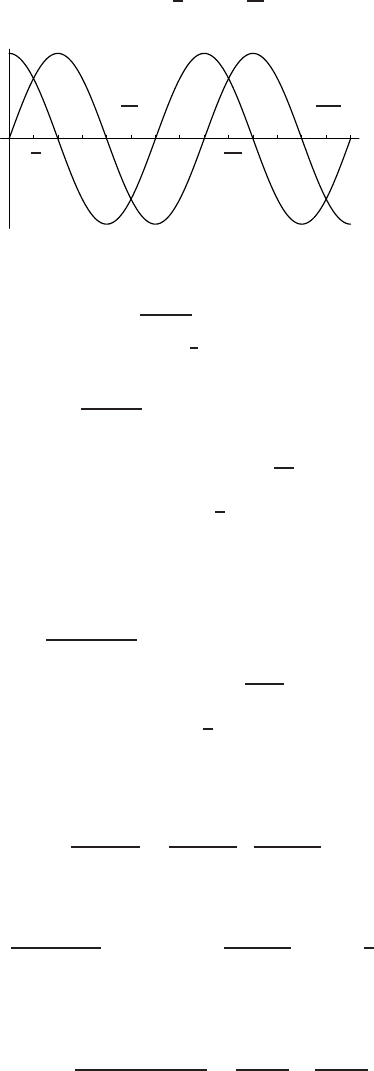
SOLUTIONS to Review Problems for Chapter Seven 699
(Note that we integrated sin x−cos xhere because for π
4≤x≤5π
4,sin x≥cos x.)
π
4
5π
4
9π
4
13π
4
x
Figure 7.48
162. In the interval of 0≤x≤2, the equation y=√4−x2represents one quadrant of the radius 2 circle centered at the
origin. Interpreting the integral as an area gives a value of 1
4π22=π.
163. Letting w= 3x5+ 2, dw = 15x4dx, we see that x4dx =dw/15, so:
Z3x4p3x5+ 2 dx =Z33x5+ 21/2·x4dx
=Z3w1/2·1
15 ·dw
=Z1
5w1/2dw,
so w= 3x5+ 2, p = 1/2, k = 1/5.
164. Letting w= cos(3θ), dw =−3 sin(3θ)dθ, we see that sin(3θ)dθ = (−1/3) dw, so:
Z5 sin(3θ)dθ
cos3(3θ)=Z5 (cos(3θ))−3sin(3θ)dθ
=Z5w−3·−dw
3
=Z−5
3w−3dw,
so w= cos(3θ), p =−3, k =−5/3.
Alternatively, if we write
5 sin(3θ)
cos3(3θ)=5 sin(3θ)
cos(3θ)·1
cos2(3θ)
and let w= tan(3θ), so dw = 3 dθ/ cos2(3θ), and we have
Z5 sin(3θ)dθ
cos3(3θ)=Z5 tan(3θ)1
cos2(3θ)dθ =Z5
3w dw,
so here w= tan(3θ), p = 1, k = 5/3.
165. Using partial fractions we have
1
(2x−3)(3x−2) =A
2x−3+B
3x−2
A(3x−2) + B(2x−3) = 1
3Ax −2A+ 2Bx −3B= 1
(3A+ 2B)x−2A−3B= 1.
We see that:
3A+ 2B= 0

700 Chapter Seven /SOLUTIONS
so A=−2
3·B
and −2A−3B= 1
−2−2
3·B−3B= 1 since A=−2
3B
4
3·B−3B= 1
−5
3B= 1
B=−3
5=−0.6
A=−2
3−3
5since A=−2
3B
=2
5= 0.4.
Thus, Zdx
(2x−3)(3x−2) =Z0.4
2x−3+−0.6
3x−2dx.
166. Let u= 0.5x−1, du = 0.5dx. Then dx = 2 du and, solving for x,
0.5x−1 = u
0.5x=u+ 1
x= 2u+ 2.
This means
x2+x= (2u+ 2)2+ 2u+ 2
= 4u2+ 10u+ 6
so
Z(x2+x)cos(0.5x−1) dx =Z(4u2+ 10u+ 6) cos u(2 du)
=Z(8u2+ 20u+ 12) cos u du,
where p(u) = 8u2+ 20u+ 12.
167. Let u=−x2, du =−2x dx, so that x dx =−0.5du. We have:
Zx3e−x2dx =Zx2
|{z}
−u
e
u
z}|{
−x2
·x dx
|{z}
−0.5du
=Z0.5ueudu,
so k= 0.5, u =−x2.
168. Letting u= cos √x, we have
du =−1
2x−1/2sin √x dx
=−sin √x dx
2√x.
So
sin √x dx
√x=−2du.
Thus,
Zcos4√xsin √x dx
√x=Zcos √x4sin √x dx
√x

SOLUTIONS to Review Problems for Chapter Seven 701
=Zcos √x4·sin √x dx
√x
=Z−2u4du,
where k=−2, n = 4, and u= cos √x.
169. After the substitution w=x2, the second integral becomes
1
2Zdw
√1−w2.
170. After the substitution w=x+ 2, the first integral becomes
Zw−2dw.
After the substitution w=x2+ 1, the second integral becomes
1
2Zw−2dw.
171. After the substitution w= 1 −x2, the first integral becomes
−1
2Zw−1dw.
After the substitution w= ln x, the second integral becomes
Zw−1dw.
172. First solution: After the substitution w=x+ 1, the first integral becomes
Zw−1
wdw =w−Zw−1dw.
With this same substitution, the second integral becomes
Zw−1dw.
Second solution: We note that the sum of the integrands is 1, so the sum of the integrals is x. Thus
Zx
x+ 1 dx =x−Z1
x+ 1 dx.
173. If we let w= 2xin the first integral, we get dw = 2dx. Also, the limits w= 0 and w= 2 become x= 0 and x= 1.
Thus Z2
0
e−w2dw =Z1
0
e−4x22dx.
174. If we let t= 3uin the first integral, we get dt = 3du, so dt/t =du/u. Also, the limits t= 0 and t= 3 become u= 0
and u= 1. Thus Z3
0
sin t
tdt =Z1
0
sin 3u
udu.
If we rename the variable uas tin the last integral, we have the equality we want.

702 Chapter Seven /SOLUTIONS
175. Since the definition of fis different on 0≤t≤1than it is on 1≤t≤2, break the definite integral at t= 1.
Z2
0
f(t)dt =Z1
0
f(t)dt +Z2
1
f(t)dt
=Z1
0
t2dt+Z2
1
(2 −t)dt
=t3
3
1
0
+2t−t2
2
2
1
= 1/3 + 1/2 = 5/6≈0.833
176. (a) (i) Multiplying out gives Z(x2+10x+ 25) dx =x3
3+ 5x2+ 25x+C.
(ii) Substituting w=x+ 5, so dw =dx, gives
Z(x+5)2dx =Zw2dw =w3
3+C=(x+ 5)3
3+C.
(b) The results of the two calculations are not the same since
(x+ 5)3
3+C=x3
3+15x2
3+75x
3+125
3+C.
However they differ only by a constant, 125/3, as guaranteed by the Fundamental Theorem of Calculus.
177. (a) Since h(z)is even, we know that R1
0h(z)dz =R0
−1h(z)dz. Since R1
−1h(z)dz =R0
−1h(z)dz +R1
0h(z)dz, we
see that R1
−1h(z)dz = 2 R1
0h(z)dz = 7. Thus R1
0h(z)dz = 3.5
(b) If w=z+ 3, then dw =dz. When z=−4,w=−1; when z=−2,w= 1. Thus,
Z−2
−4
5h(z+3) dt = 5 Z1
−1
h(w) (dw) = 5 ·7 = 35.
178. The point of intersection of the two curves y=x2and y= 6 −xis at (2,4). The average height of the shaded area is the
average value of the difference between the functions:
1
(2 −0) Z2
0
((6 −x)−x2)dx = (3x−x2
4−x3
6)
2
0
=11
3.
179. The average width of the shaded area in the figure below is the average value of the horizontal distance between the two
functions. If we call this horizontal distance h(y), then the average width is
1
(6 −0) Z6
0
h(y)dy.
x
y
y=x2
y= 6 −x
We could compute this integral if we wanted to, but we don’t need to. We can simply note that the integral (without
the 1
6term) is just the area of the shaded region; similarly, the integral in Problem 178 is also just the area of the shaded
region. So they are the same. Now we know that our average width is just 1
3as much as the average height, since we
divide by 6 instead of 2. So the answer is 11
9.

SOLUTIONS to Review Problems for Chapter Seven 703
180. (a) i. 0 ii. 2
πiii. 1
2
(b) Average value of f(t)<Average value of k(t)<Average value of g(t)
We can look at the three functions in the range −π
2≤x≤3π
2, since they all have periods of 2π(|cos t|
and (cos t)2also have a period of π, but that does not hurt our calculation). It is clear from the graphs of the three
functions below that the average value for cos tis 0 (since the area above the x-axis is equal to the area below it),
while the average values for the other two are positive (since they are everywhere positive, except where they are 0).
−π
2
π
2π
3π
2
f(t)
t
−π
2
π
2π3π
2
f(t)
t
−π
2
π
2π3π
2
f(t)
t
It is also fairly clear from the graphs that the average value ofg(t)is greater than the average value of k(t); it is
also possible to see this algebraically, since
(cos t)2=|cos t|2≤ |cos t|
because |cos t| ≤ 1(and both of these ≤’s are <’s at all the points where the functions are not 0 or 1).
181. This calculation cannot be correct because the integrand is positive everywhere, yet the value given for the integral is
negative.
The calculation is incorrect because the integral is improper but has not been treated as such. The integral is improper
because the integrand 1/x2is undefined at x= 0. To determine whether the integral converges we split the integral into
two improper integrals: Z2
−2
1
x2dx =Z0
−2
1
x2dx +Z2
0
1
x2dx.
To decide whether the second integral converges, we compute
Z2
0
1
x2dx = lim
a→0+Z2
a
1
x2dx = lim
a→0+−1
2+1
a.
The limit does not exist, and R2
0(1/x2)dx diverges, so the original the integral R2
−21/x2dx diverges.
182. (a) We have
E(x) + F(x) = Zex
ex+e−xdx +Ze−x
ex+e−xdx =Zex+e−x
ex+e−xdx =Z1dx =x+C1.
(b) We have
E(x)−F(x) = Zex
ex+e−xdx −Ze−x
ex+e−xdx =Zex−e−x
ex+e−xdx = ln ex+e−x+C2,
by using the substitution w=ex+e−xin the final integral.
(c) We have
E(x) + F(x) = x+C1
E(x)−F(x) = ln ex+e−x+C2.
Adding and subtracting we find
E(x) = x
2+1
2ln ex+e−x+C,
where the arbitrary constant C= (C1+C2)/2, and
F(x) = x
2−1
2ln ex+e−x+C,
where C= (C1−C2)/2.

704 Chapter Seven /SOLUTIONS
183. Since f(x)is decreasing on [a, b], the left-hand Riemann sums are all overestimates and the right-hand sums are all
underestimates. Because increasing the number of subintervals generally brings an approximation closer to the actual
value, LEFT(10) is closer to the actual value (i.e., smaller, since the left sums are overestimates) than LEFT(5), and
analogously for RIGHT(10) and RIGHT(5). Since the graph of f(x)is concave down, a secant line lies below the curve
and a tangent line lies above the curve. Therefore, TRAP is an underestimate and MID is an overestimate. Putting these
observations together, we have
RIGHT(5) <RIGHT(10) <TRAP(10) <Exact value <MID(10) <LEFT(10) <LEFT(5).
184. (a) f(x) = 1 + e−xis concave up for 0≤x≤0.5, so trapezoids will overestimate Z0.5
0
f(x)dx, and the midpoint
rule will underestimate.
(b) f(x) = e−x2is concave down for 0≤x≤0.5,so trapezoids will underestimate Z0.5
0
f(x)dx and midpoint will
overestimate the integral.
(c) Both the trapezoid rule and the midpoint rule will give the exact value of the integral. Note that upper and lower sums
will not, unless the line is horizontal.
185. (a) For the left-hand rule, error is approximately proportional to 1
n. If we let npbe the number of subdivisions needed
for accuracy to pplaces, then there is a constant ksuch that
5×10−5=1
2×10−4≈k
n4
5×10−9=1
2×10−8≈k
n8
5×10−13 =1
2×10−12 ≈k
n12
5×10−21 =1
2×10−20 ≈k
n20
Thus the ratios n4:n8:n12 :n20 ≈1 : 104: 108: 1016, and assuming the computer time necessary is proportional
to np, the computer times are approximately
4 places: 2 seconds
8 places: 2×104seconds ≈6hours
12 places: 2×108seconds ≈6years
20 places: 2×1016 seconds ≈600 million years
(b) For the trapezoidal rule, error is approximately proportional to 1
n2. If we let Npbe the number of subdivisions needed
for accuracy to pplaces, then there is a constant Csuch that
5×10−5=1
2×10−4≈C
N42
5×10−9=1
2×10−8≈C
N82
5×10−13 =1
2×10−12 ≈C
N122
5×10−21 =1
2×10−20 ≈C
N202
Thus the ratios N42:N82:N122:N202≈1 : 104: 108: 1016, and the ratios N4:N8:N12 :N20 ≈1 : 102:
104: 108. So the computer times are approximately
4 places: 2 seconds
8 places: 2×102seconds ≈3minutes
12 places: 2×104seconds ≈6hours
20 places: 2×108seconds ≈6years

SOLUTIONS to Review Problems for Chapter Seven 705
186. Use integration by parts, with u=xand dv =xe−x2. Then v=−(1/2)e−x2, and
Zb
0
x2e−x2dx =−1
2xe−x2
b
0
+Zb
0
1
2e−x2dx
=−1
2be−b2+1
2Zb
0
e−x2dx.
Since the exponential grows faster than any power,
lim
b→∞ be−b2= lim
b→∞
b
eb2= 0.
So Zb
0
x2e−x2dx = 0 + 1
2Z∞
0
e−x2dx =1
2·√π
2=√π
4.
187. (a) We calculate the integral using partial fractions with denominators Pand L−P:
k
P(L−P)=A
P+B
L−P
k=A(L−P) + BP
k= (B−A)P+AL.
Thus,
B−A= 0
AL =k,
so A=B=k/L, and the time is given by
T=ZL/2
L/4
k dP
P(L−P)=k
LZL/2
L/41
P+1
L−PdP =k
L(ln |P| − ln |L−P|)
L/2
L/4
=k
Lln L
2−ln L
2−ln L
4+ ln 3L
4
=k
Lln 3L/4
L/4=k
Lln (3) .
(b) A similar calculation gives the following expression for the time:
T=k
L(ln |P| − ln |L−P|)
P2
P1
=k
L(ln |P2| − ln |L−P2| − ln |P1|+ ln |L−P1|).
If P2→L, then L−P2→0, so ln P2→ln L, and ln(L−P2)→ −∞. Thus the time tends to infinity.
188. If I(t)is average per-capita income tyears after 2005, then I′(t) = r(t).
(a) Since t= 10 in 2015, by the Fundamental Theorem,
I(10) −I(0) = Z10
0
r(t)dt =Z10
0
1556.37e0.045tdt =1556.37
0.045 e0.045t
10
0
=19,655.65 dollars.
so I(10) = 34,586 + 19,655.65 = 54,241.65.
(b) We have
I(t)−I(0) = Zt
0
r(t)dt=Zt
0
1556.37e0.045tdt =1556.37
0.045 e0.045t
t
0
=34,586 e0.045t−1.
Thus, since I(0) = 34,586,
I(t) = 34,586 + 34,586(e0.045t−1) = 34,586e0.045tdollars.

706 Chapter Seven /SOLUTIONS
189. (a) Since the rate is given by r(t) = 2te−2tml/sec, by the Fundamental Theorem of Calculus, the total quantity is given
by the definite integral:
Total quantity ≈Z∞
0
2te−2tdt = 2 lim
b→∞ Zb
0
te−2tdt.
Integration by parts with u=t,v′=e−2tgives
Total quantity ≈2 lim
b→∞ −t
2e−2t−1
4e−2t
b
0
= 2 lim
b→∞ 1
4−b
2+1
4e−2b= 2 ·1
4= 0.5ml.
(b) At the end of 5 seconds,
Quantity received =Z5
0
2te−2tdt ≈0.49975 ml.
Since 0.49975/0.5 = 0.9995 = 99.95%, the patient has received 99.95% of the dose in the first 5 seconds.
190. The rate at which petroleum is being used tyears after 1990 is given by
r(t) = 1.4·1020(1.02)tjoules/year.
Between 1990 and Myears later
Total quantity of petroleum used =ZM
0
1.4·1020(1.02)tdt = 1.4·1020 (1.02)t
ln(1.02)
M
0
=1.4·1020
ln(1.02) ((1.02)M−1) joules.
Setting the total quantity used equal to 1022 gives
1.4·1020
ln(1.02) (1.02)M−1= 1022
(1.02)M=100 ln(1.02)
1.4+ 1 = 2.41
M=ln(2.41)
ln(1.02) ≈45 years.
So we will run out of petroleum in 2035.
191. (a) We have
S=Z18
0
(30 −10)dt = 20 Z18
0
dt = 20(18 −0) = 360.
The units of Sare degree-days, because the integrand f(t)−10 has units of ◦C, and dt has units of days.
(b) In Figure 7.49, f(t)and Hmin are represented by the horizontal lines at H= 30 and H= 10, and Tis represented
by a vertical line at t= 18. The value of S, given by the definite integral, is represented by the area of the rectangle
bounded by the vertical lines t= 0 (the H-axis) and t= 18, and the horizontal lines H= 10 and H= 30.
(c) The temperature cycles from a high of 30◦C to a low of 10◦C once every 6 days. During the 18-day period the
temperature completes 3 complete cycles. The area between this curve and the horizontal line H=Hmin = 10 gives
the value of the definite integral. See Figure 7.50. In order to get the same area as before, (namely S= 360), we see
that T2must be larger than T= 18. Thus we want T2to satisfy:
S=ZT2
0
(g(t)−10)dt =ZT2
010 cos 2πt
6+ 10dt = 360.
Notice that, by symmetry, the area on the interval 0≤t≤18 is half the area shown in Figure 7.49. Thus, we expect
that T2= 2T= 36. We can check this by calculation, using a substitution to evaluate the integral:
S=Z36
010 cos 2πt
6+ 10dt =10 ·6
2πsin 2πt
6+ 10t
T2
0
= 360.
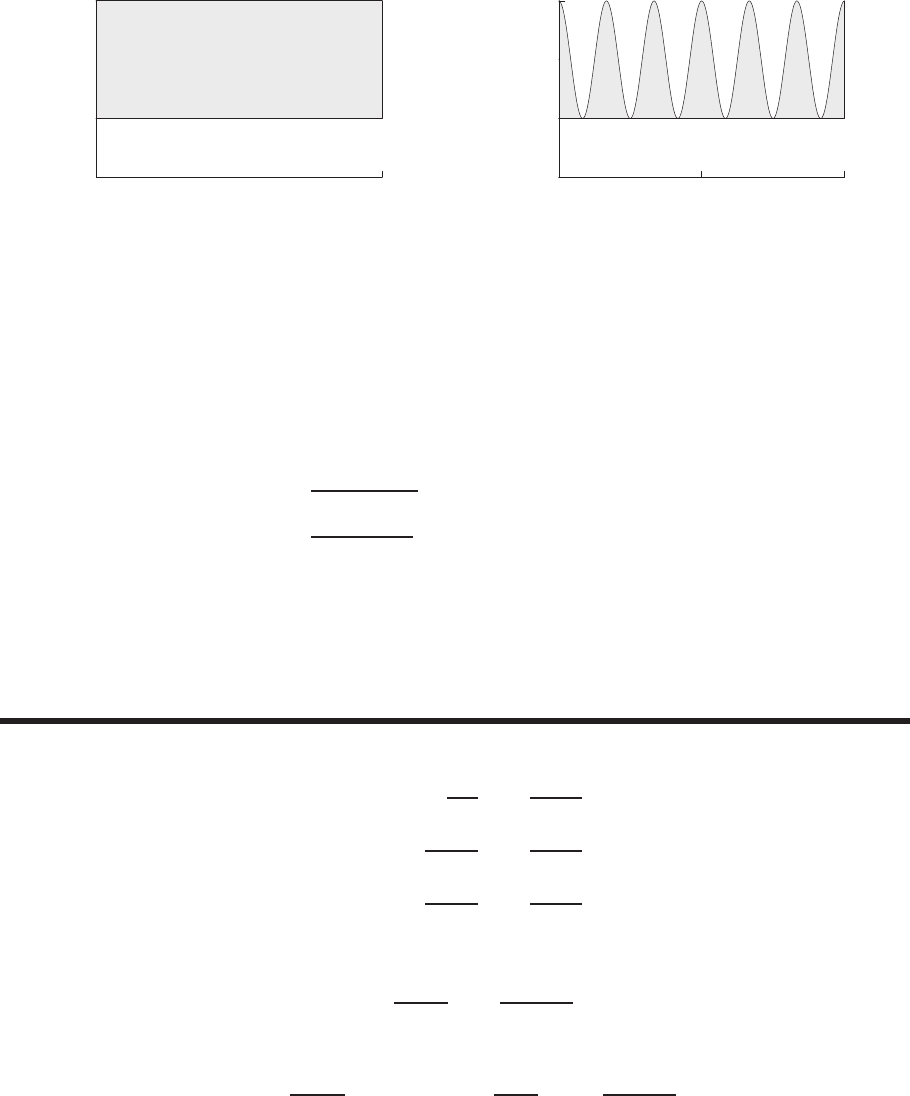
SOLUTIONS to Review Problems for Chapter Seven 707
Thus, if T2= 36, the integral evaluates to S= 360, as required. Thus, 36 days are required for development for with
these temperatures.
18
10
30
H=Hmin = 10
H=f(t) = 30
t=T= 18
S=
Area
= 360
t
, days
H
,
◦
C
Figure 7.49
18 36
10
20
30
H=Hmin
H=g(t)t=T2
S=
Area
= 360
x
y
Figure 7.50
192. We want to calculate Z1
0
Cnsin(nπx)·Cmsin(mπx)dx.
We use II-11 from the table of integrals with a=nπ,b=mπ. Since n6=m, we see that
Z1
0
Ψn(x)·Ψm(x)dx=CnCmZ1
0
sin(nπx) sin(mπx)dx
=CnCm
m2π2−n2π2(nπ cos(nπx) sin(mπx)−mπ sin(nπx) cos(mπx))
1
0
=CnCm
(m2−n2)π2nπ cos(nπ) sin(mπ)−mπ sin(nπ) cos(mπ)
−nπ cos(0) sin(0) + mπ sin(0) cos(0)
= 0
since sin(0) = sin(nπ) = sin(mπ) = 0.
CAS Challenge Problems
193. (a) A CAS gives
Zln x
xdx =(ln x)2
2
Z(ln x)2
xdx =(ln x)3
3
Z(ln x)3
xdx =(ln x)4
4
(b) Looking at the answers to part (a), Z(ln x)n
xdx =(ln x)n+1
n+ 1 +C.
(c) Let w= ln x. Then dw = (1/x)dx, and
Z(ln x)n
xdx =Zwndw =wn+1
n+ 1 +C=(ln x)n+1
n+C.

708 Chapter Seven /SOLUTIONS
194. (a) A CAS gives
Zln x dx =−x+xln x
Z(ln x)2dx= 2x−2xln x+x(ln x)2
Z(ln x)3dx =−6x+ 6xln x−3x(ln x)2+x(ln x)3
Z(ln x)4dx= 24x−24xln x+ 12x(ln x)2−4x(ln x)3+x(ln x)4
(b) In each of the cases in part (a), the expression for the integral R(ln x)ndx has two parts. The first part is simply a
multiple of the expression for R(ln x)n−1dx. For example, R(ln x)2dx starts out with 2x−2xln x=−2Rln x dx.
Similarly, R(ln x)3dx starts out with −6x+ 6xln x−3(ln x)2=−3R(ln x)2dx, and R(ln x)4dx starts out with
−4R(ln x)3dx. The remaining part of each antiderivative is a single term: it’s x(ln x)2in the case n= 2, it’s
x(ln x)3for n= 3, and it’s x(ln x)4for n= 4. The general pattern is
Z(ln x)ndx=−nZ(ln x)n−1dx +x(ln x)n.
To check this formula, we use integration by parts. Let u= (ln x)nso u′=n(ln x)n−1/x and v′= 1 so v=x.
Then
Z(ln x)ndx=x(ln x)n−Zn(ln x)n−1
x·x dx
Z(ln x)ndx =x(ln x)n−nZ(ln x)n−1dx.
This is the result we obtained before.
Alternatively, we can check our result by differentiation:
d
dx −nZ(ln x)n−1dx +x(ln x)n=−n(ln x)n−1+d
dx (x(ln x)n)
=−n(ln x)n−1+ (ln x)n+x·n(ln x)n−11
x
=−n(ln x)n−1+ (ln x)n+n(ln x)n−1= (ln x)n.
Therefore, Z(ln x)ndx=−nZ(ln x)n−1dx +x(ln x)n.
195. (a) A possible answer from the CAS is
Zsin3xdx =−9 cos(x) + cos(3 x)
12 .
(b) Differentiating
d
dx −9 cos(x) + cos(3 x)
12 =9 sin(x)−3 sin(3 x)
12 =3 sin x−sin(3x)
4.
(c) Using the identities, we get
sin(3x) = sin(x+ 2x) = sin xcos 2x+ cos xsin 2x
= sin x(1 −2 sin2x) + cos x(2 sin xcos x)
= sin x−2 sin3x+ 2 sin x(1 −sin2x)
= 3 sin x−4 sin3x.
Thus,
3 sin x−sin(3x) = 3 sin x−(3 sin x−4 sin3x) = 4 sin3x,
so 3 sin x−sin(3x)
4= sin3x.

PROJECTS FOR CHAPTER SEVEN 709
196. (a) A possible answer is Zsin xcos xcos(2x)dx =−cos(4x)
16 .
Different systems may give the answer in a different form.
(b)
d
dx −cos(4x)
16 =sin(4x)
4.
(c) Using the double angle formula sin 2A= 2 sin Acos Atwice, we get
sin(4x)
4=2 sin(2x) cos(2x)
4=2·2 sin xcos xcos(2x)
4= sin xcos xcos(2x).
197. (a) A possible answer from the CAS is
Zx4
(1 + x2)2dx =x+x
2 (1 + x2)−3
2arctan(x).
Different systems may give the answer in different form.
(b) Differentiating gives
d
dx x+x
2 (1 + x2)−3
2arctan(x)= 1 −x2
(1 + x2)2−1
1 + x2.
(c) Putting the result of part (b) over a common denominator, we get
1−x2
(1 + x2)2−1
1 + x2=1 + x22−x2−(1 + x2)
(1 + x2)2
=1 + 2x2+x4−x2−1−x2
(1 + x2)2=x4
(1 + x2)2.
PROJECTS FOR CHAPTER SEVEN
1. (a) If et≥1 + t, then
ex= 1 + Zx
0
etdt
≥1 + Zx
0
(1 + t)dt= 1 + x+1
2x2.
We can keep going with this idea. Since et≥1 + t+1
2t2,
ex= 1 + Zx
0
etdt
≥1 + Zx
0
(1 + t+1
2t2)dt = 1 + x+1
2x2+1
6x3.
We notice that each term in our summation is of the form xn
n!. Furthermore, we see that if we have a sum
1 + x+x2
2+··· +xn
n!such that
ex≥1+x+x2
2+···+xn
n!,
then
ex= 1 + Zx
0
etdt
≥1 + Zx
01 + t+t2
2+···+tn
n!dt
= 1 + x+x2
2+x3
6+···+xn+1
(n+ 1)!.

710 Chapter Seven /SOLUTIONS
Thus we can continue this process as far as we want, so
ex≥1+x+1
2x2+··· +1
n!xn=
n
X
j=0
xj
j!for any n.
(In fact, it turns out that if you let nget larger and larger and keep adding up terms, your values approach
exactly ex.)
(b) We note that sin x=Zx
0
cos t dt and cos x= 1 −Zx
0
sin t dt. Thus, since cos t≤1,we have
sin x≤Zx
0
1dt=x.
Now using sin t≤t, we have
cos x≤1−Zx
0
t dt =1−1
2x2.
Then we just keep going:
sin x≤Zx
01−1
2t2dt =x−1
6x3.
Therefore
cos x≤1−Zx
0t−1
6t3dt = 1 −1
2x2+1
24x4.
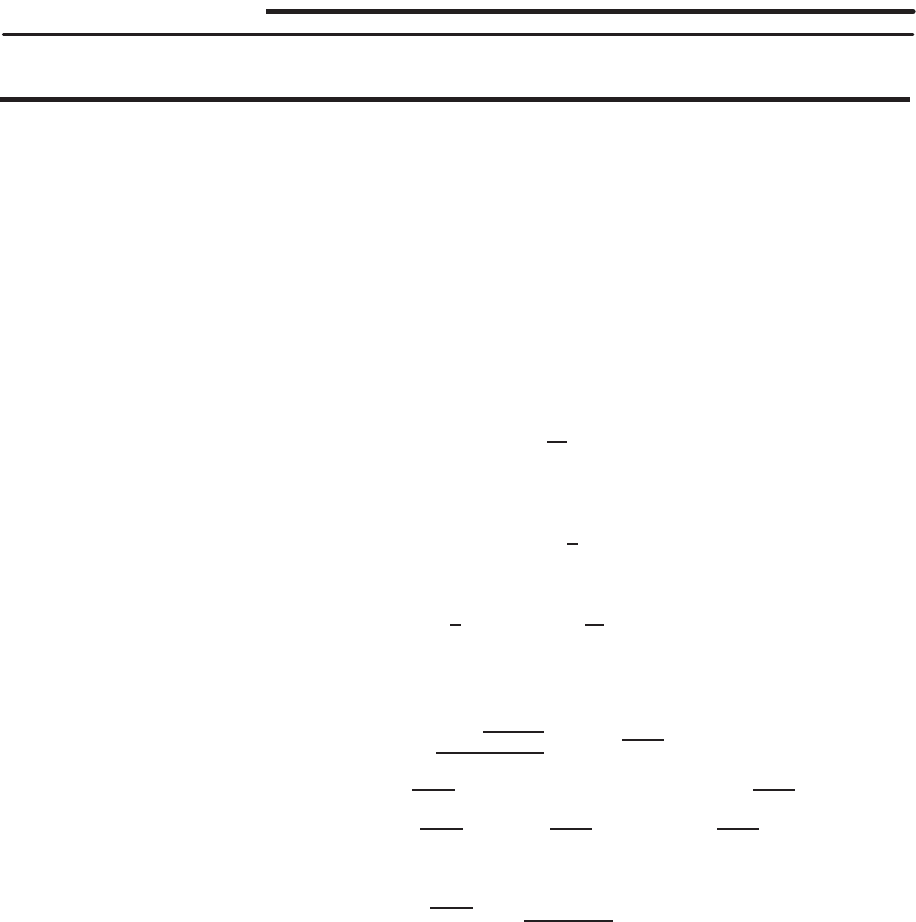
8.1 SOLUTIONS 711
CHAPTER EIGHT
Solutions for Section 8.1
Exercises
1. (a) The strip stretches between y= 0 and y= 2x, so
Area of region ≈X(2x)∆x.
(b) We have
Area =Z3
0
(2x)dx =x2
3
0
= 9.
2. (a) The strip stretches between y= 0 and y=−x2+ 6x, so
Area of region ≈X(−x2+6x)∆x.
(b) We have
Area =Z6
0
(−x2+ 6x)dx =−x3
3+ 3x2
6
0
= 36.
3. (a) The strip stretches from x=y/2to x= 3, so
Area of region ≈X3−y
2∆y.
(b) We have
Area =Z6
03−y
2dy =3y−y2
4
6
0
=9.
4. (a) The equation y=−x2+ 6xcan be solved for xas
x2−6x+y= 0
x=6±√36 −4y
2= 3 ±p9−y.
The left end of the strip is given by x= 3 −√9−y, and the right end is given by x= 3 + √9−y. Thus,
Area of region ≈X((3 + p9−y)−(3 −p9−y))∆y=X2p9−y∆y.
(b) We have
Area =Z9
0
2p9−y dy =2(9 −y)3/2
−3/2
9
0
= 36.
5. Each strip is a rectangle of length 3 and width ∆x, so
Area of strip = 3∆x, so
Area of region =Z5
0
3dx= 3x
5
0
= 15.
Check: This area can also be computed using Length ×Width = 5 ·3 = 15.

712 Chapter Eight /SOLUTIONS
6. Using similar triangles, the height, y, of the strip is given by
y
3=x
6so y=x
2.
Thus,
Area of strip ≈y∆x=x
2∆x,
so
Area of region =Z6
0
x
2dx =x2
4
6
0
= 9.
Check: This area can also be computed using the formula 1
2Base ·Height =1
2·6·3 = 9.
7. By similar triangles, if wis the length of the strip at height h, we have
w
3=5−h
5so w= 3 1−h
5.
Thus,
Area of strip ≈w∆h= 3 1−h
5∆h.
Area of region =Z5
0
31−h
5dh =3h−3h2
10
5
0
=15
2.
Check: This area can also be computed using the formula 1
2Base ·Height =1
2·3·5 = 15
2.
8. Suppose the length of the strip shown is w. Then the Pythagorean theorem gives
h2+w
22
= 32so w= 2p32−h2.
Thus
Area of strip ≈w∆h= 2p32−h2∆h,
Area of region =Z3
−3
2p32−h2dh.
Using VI-30 in the Table of Integrals, we have
Area =hp32−h2+ 32arcsin h
3
3
−3
= 9(arcsin 1 −arcsin(−1)) = 9π.
Check: This area can also be computed using the formula πr2= 9π.
9. The strip has width ∆y, so the variable of integration is y. The length of the strip is x. Since x2+y2= 10 and the region
is in the first quadrant, solving for xgives x=p10 −y2. Thus
Area of strip ≈x∆y=p10 −y2dy.
The region stretches from y= 0 to y=√10, so
Area of region =Z√10
0p10 −y2dy.
Evaluating using VI-30 from the Table of Integrals, we have
Area =1
2yp10 −y2+ 10 arcsin y
√10
√10
0
= 5(arcsin 1 −arcsin 0) = 5
2π.
Check: This area can also be computed using the formula 1
4πr2=1
4π(√10)2=5
2π.

8.1 SOLUTIONS 713
10. The strip has width ∆y, so the variable of integration is y. The length of the strip is 2xfor x≥0. For positive x, we have
x=y. Thus,
Area of strip ≈2x∆y= 2y∆y.
Since the region extends from y= 0 to y= 4,
Area of region =Z4
0
2ydy =y2
4
0
= 16.
Check: The area of the region can be computed by 1
2Base ·Height =1
2·8·4 = 16.
11. The width of the strip is ∆y, so the variable of integration is y. Since the graphs are x=yand x=y2, the length of the
strip is y−y2, and
Area of strip ≈(y−y2)∆y.
The curves cross at the points (0,0) and (1,1), so
Area of region =Z1
0
(y−y2)dy=y2
2−y3
3
1
0
=1
6.
12. The width of the strip is ∆x, so the variable of integration is x. The line has equation y= 6 −3x. The length of the strip
is 6−3x−(x2−4) = 10 −3x−x2. (Since x2−4is negative where the graph is below the x-axis, subtracting x2−4
there adds the length below the x-axis.) Thus
Area of strip ≈(10 −3x−x2)∆x.
Both graphs cross the x-axis where x= 2, so
Area of region =Z2
0
(10 −3x−x2)dx = 10x−3
2x2−x3
3
2
0
=34
3.
13. Each slice is a circular disk with radius r= 2 cm.
Volume of disk =πr2∆x= 4π∆xcm3.
Summing over all disks, we have
Total volume ≈X4π∆xcm3.
Taking a limit as ∆x→0, we get
Total volume = lim
∆x→0X4π∆x=Z9
0
4π dx cm3.
Evaluating gives
Total volume = 4πx
9
0
=36πcm3.
Check: The volume of the cylinder can also be calculated using the formula V=πr2h=π22·9 = 36πcm3.
14. Each slice is a circular disk. Since the radius of the cone is 2 cm and the length is 6 cm, the radius is one-third of the
distance from the vertex. Thus, the radius at xis r=x/3cm. See Figure 8.1.
Volume of slice ≈πr2∆x=πx2
9∆xcm3.
Summing over all disks, we have
Total volume ≈Xπx2
9∆xcm3.
Taking a limit as ∆x→0, we get
Total volume = lim
∆x→0Xπx2
9∆x=Z6
0
πx2
9dx cm3.

714 Chapter Eight /SOLUTIONS
Evaluating, we get
Total volume =π
9
x3
3
6
0
=π
9·63
3= 8πcm3.
Check: The volume of the cone can also be calculated using the formula V=1
3πr2h=1
3π22·6 = 8πcm3.
0
✻
❄
x/3
✻
❄
2
cm
✲✛ 6
cm
✲✛ xx
Figure 8.1
15. Each slice is a circular disk. From Figure 8.2, we see that the radius at height yis r=2
5ycm. Thus
Volume of disk ≈πr2∆y=π2
5y2
∆y=4
25 πy2∆ycm3.
Summing over all disks, we have
Total volume ≈X4π
25 y2∆ycm3.
Taking the limit as ∆y→0, we get
Total volume = lim
∆y→0X4π
25 y2∆y=Z5
0
4π
25 y2dy cm3.
Evaluating gives
Total volume =4π
25
y3
3
5
0
=20
3πcm3.
Check: The volume of the cone can also be calculated using the formula V=1
3πr2h=π
322·5 = 20
3πcm3.
✻
❄
5
cm
✲✛
2
5y
✻
❄
y
✲✛ 2
Figure 8.2
16. Each slice is a rectangular slab of length 10 m and width that decreases with height. See Figure 8.3. At height y, the length
xis given by the Pythagorean Theorem
y2+x2= 72.
Solving gives x=p72−y2m. Thus the width of the slab is 2x= 2p72−y2and
Volume of slab =Length ·Width ·Height = 10 ·2p72−y2·∆y= 20p72−y2∆ym3.
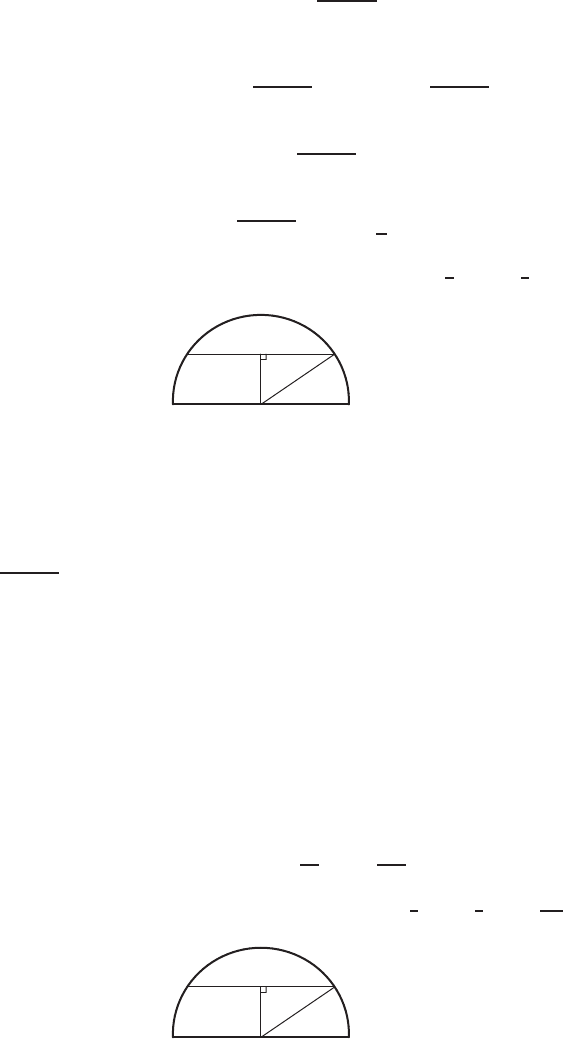
8.1 SOLUTIONS 715
Summing over all slabs, we have
Total volume ≈X20p72−y2∆ym3.
Taking a limit as ∆y→0, we get
Total volume = lim
∆y→0X20p72−y2∆y=Z7
0
20p72−y2dy m3.
To evaluate, we use the table of integrals or the fact that Z7
0p72−y2dy represents the area of a quarter circle of radius
7, so
Total volume =Z7
0
20p72−y2dy = 20 ·1
4π72= 245πm3.
Check: the volume of a half cylinder can also be calculated using the formula V=1
2πr2h=1
2π72·10 = 245πm3.
y7
x
Figure 8.3
17. Each slice is a circular disk. See Figure 8.4. The radius of the sphere is 5 mm, and the radius rat height yis given by the
Pythagorean Theorem
y2+r2= 52.
Solving gives r=p52−y2mm. Thus,
Volume of disk ≈πr2∆y=π(52−y2)∆ymm3.
Summing over all disks, we have
Total volume ≈Xπ(52−y2)∆ymm3.
Taking the limit as ∆y→0, we get
Total volume = lim
∆y→0Xπ(52−y2)∆y=Z5
0
π(52−y2)dy mm3.
Evaluating gives
Total volume =π25y−y3
3
5
0
=250
3πmm3.
Check: The volume of a hemisphere can be calculated using the formula V=2
3πr3=2
3π53=250
3πmm3.
y5
r
Figure 8.4

716 Chapter Eight /SOLUTIONS
18. Each slice is a square; the side length decreases as we go up the pyramid. See Figure 8.5. Since the base of the pyramid is
equal to its vertical height, the slice at distance yfrom the base, or (2 −y)from the top, has side (2 −y). Thus
Volume of slice ≈(2 −y)2∆ym3.
Summing over all slices, we get
Total volume ≈X(2 −y)2∆ym3.
Total volume = lim
∆y→0X(2 −y)2∆y=Z2
0
(2 −y)2dy m3.
Evaluating, we find
Total volume =Z2
0
(4−4y+y2)dy =4y−2y2+y3
3
2
0
=8
3m3.
Check: The volume of the pyramid can also be calculated using the formula V=1
3b2h=1
322·2 = 8
3m3.
✻
❄
(2 −y)
✻
❄
y
✲✛ 2
m
✻
❄
2
m
✲✛ (2 −y)
Figure 8.5
Problems
19. Triangle of base and height 1 and 3. See Figure 8.6. (Either 1 or 3 can be the base. A non-right triangle is also possible.)
✻
❄
3
✲✛ 1
✲ ✛
∆x
✲✛ x
Figure 8.6
20. Semicircle of radius r= 9. See Figure 8.7.
✲✛ 9
✲ ✛
∆x
✲✛
x
Figure 8.7
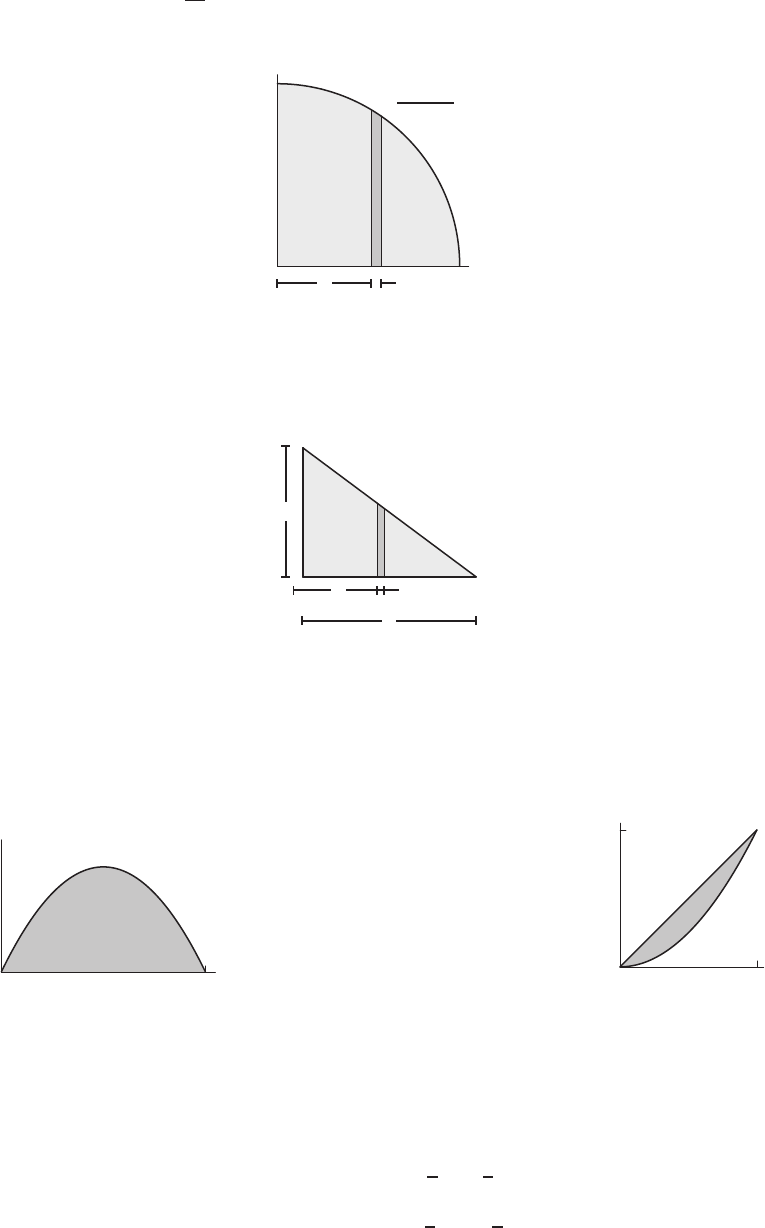
8.1 SOLUTIONS 717
21. Quarter circle of radius r=√15. See Figure 8.8.
√15 −h2
✲ ✛
∆h
✲✛ h
h
y
Figure 8.8
22. Triangle of base and height 7 and 5. See Figure 8.9. (Either 7 or 5 can be the base. A non-right triangle is also possible.)
✻
❄
5
✲✛ 7
✲ ✛
∆h
✲✛ h
Figure 8.9
23. There are at least two possible answers. Since y=x−x2≥0when 0≤x≤1,one possibility is that the integral gives
the area between the parabola y=x−x2and the line y= 0 as shown in Figure 8.10. Alternatively, since x≥x2when
0≤x≤1,the integral gives the area between the curves y=x2and y=x, as shown in Figure 8.11.
1x
y
Figure 8.10
1
1
x
y
Figure 8.11
24. (a) The area is shown in Figure 8.12(a) with one vertical slice shown. Each slice is bounded on the top by y= 3xand on
the bottom by y=x2, so the height of each slice is 3x−x2. The width of each slice is ∆x, so the area is represented
by
A=Z3
0
(3x−x2)dx =3
2x2−1
3x3
3
0
=3
2·32−1
3˙
33−(0 −0)
= 4.5.
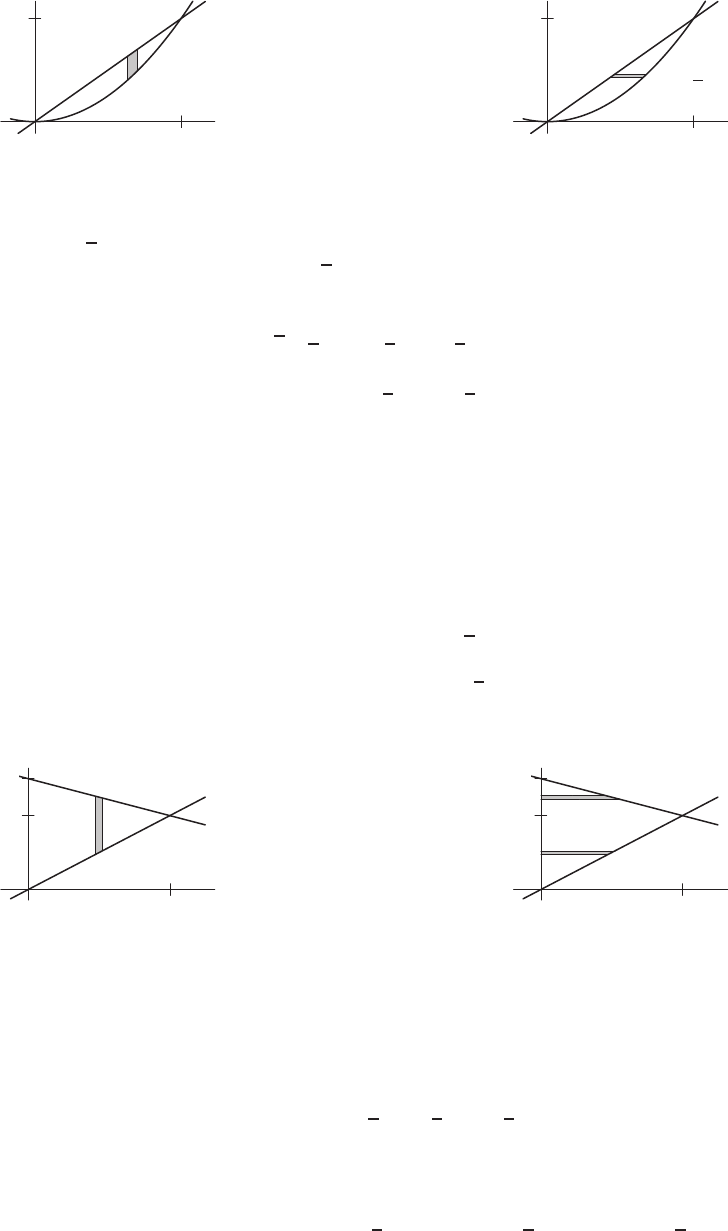
718 Chapter Eight /SOLUTIONS
3
9
y=x2
y= 3x
x
y
(a)
3
9
x=√y
x=y/3
x
y
(b)
Figure 8.12
(b) The area is shown in Figure 8.12(b) with one horizontal slice shown. Each slice is bounded on the right by y=x2,
which is x=√ydistance out from the y-axis, and is bounded on the left by y= 3x, which is x=y/3distance
out from the y-axis. The length of each slice is √y−y/3. The width of each slice is ∆y, and the area extends from
y= 0 to y= 9 so the area is represented by
A=Z9
0√y−y
3dy =2
3y3/2−1
6y2
9
0
=2
3·93/2−1
6·92−(0 −0)
= 4.5.
Notice that the two ways of computing the area give the same answer, as we expect.
25. (a) The area is shown in Figure 8.13(a) with one vertical slice shown. Each slice is bounded on the top by y= 12 −x
and on the bottom by y= 2x, so the height of each slice is (12 −x)−2x. The width of each slice is ∆xand the
area ranges from x= 0 to x= 4, so the area is represented by
A=Z4
0
((12 −x)−2x)dx =Z4
0
12 −3x dx
= 12x−3
2x2
4
0
= 12 ·4−3
2·42−(0 −0)
= 24.
4
8
12 y= 12 −x
y= 2x
x
y
(a)
4
8
12 x= 12 −y
x=y/2
x
y
(b)
Figure 8.13
(b) The area is shown in Figure 8.13(b) with two horizontal slices shown. Because some of the slices are bounded on the
right by y= 12 −xwhile others are bounded on the right by y= 2x, we use two separate integrals to calculate
this area using horizontal slices. The slices between y= 0 and y= 8 are bounded on the right by y= 2x, which is
x=y/2distance from the y-axis, and are bounded on the left by the y-axis, which is x= 0. This part of the area is
given by
Bottom part of the area =Z8
0
y
2dy =1
4y2
8
0
=1
4·82−0 = 16.
The slices between y= 8 and y= 12 are bounded on the right by y= 12 −x, which is x= 12 −ydistance from
the y-axis, and are bounded on the left by the y-axis, which is x= 0. This part of the area is given by
Top part of the area =Z12
8
(12 −y)dy = 12y−1
2y2
12
8
= 12 ·12 −1
2·122−12 ·8−1
2·82= 8.
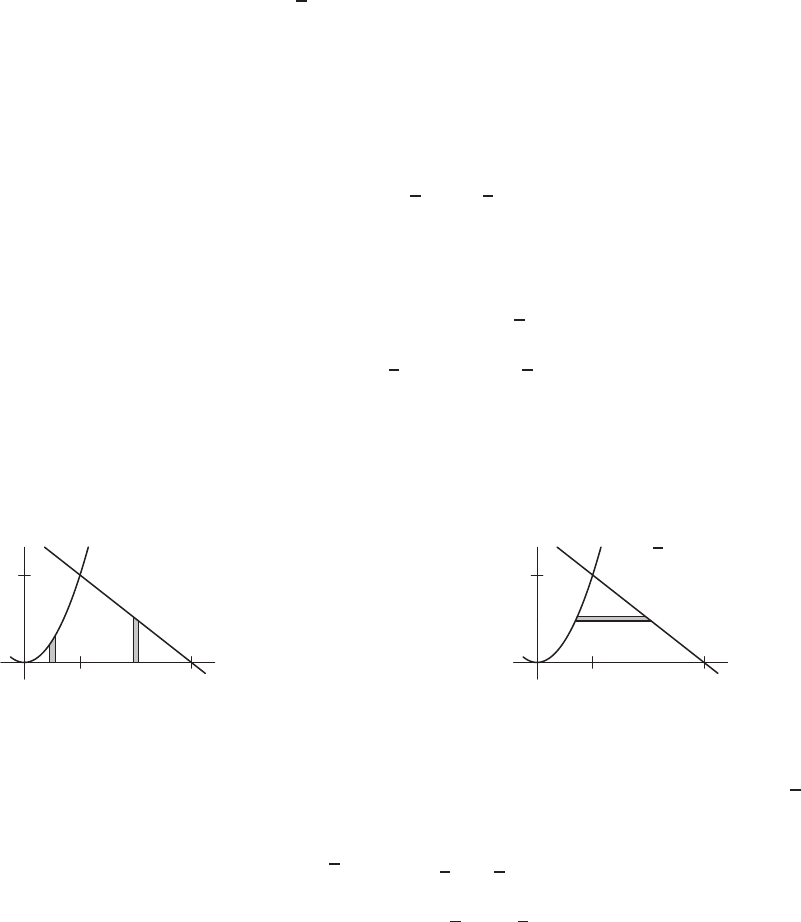
8.1 SOLUTIONS 719
The total area is given by
Total area =Z8
0
y
2dy +Z12
8
(12 −y)dy = 16 + 8 = 24.
Notice that the two ways of computing the area give the same answer, as we expect.
26. (a) The area is shown in Figure 8.14(a) with two vertical slices shown. Because some of the slices are bounded on the
top by y=x2while others are bounded on the top by y= 6 −x, we use two separate integrals to calculate this area
using vertical slices. The slices between x= 0 and x= 2 are bounded on the top by y=x2and are bounded on the
bottom by the x-axis, which is y= 0. This part of the area is given by
Left part of the area =Z2
0
x2dx=1
3x3
2
0
=1
3·23−0 = 2.667.
The slices between x= 2 and x= 6 are bounded on the top by y= 6 −xand are bounded on the bottom by the
x-axis, which is y= 0. This part of the area is given by
Right part of the area =Z6
2
(6−x)dx = 6x−1
2x2
6
2
= 6 ·6−1
2·62−6·2−1
2·22= 8.
The total area is given by
Total area =Z2
0
x2dx+Z6
2
(6 −x)dx = 2.667 + 8 = 10.667.
2 6
4
y=x2
y= 6 −x
x
y
(a)
2 6
4
y=√y
x= 6 −y
x
y
(b)
Figure 8.14
(b) The area is shown in Figure 8.14(b) with one horizontal slice shown. The slices are all bounded on the right by
y= 6 −x, which is x= 6 −ydistance from the y-axis, and are bounded on the left by y=x2, which is x=√y
distance from the y-axis. The area ranges from y= 0 to y= 4 so the area is given by
A=Z4
0
((6 −y)−√y)dy = 6y−1
2y2−2
3·y3/2
4
0
= 6 ·4−1
2·42−2
3·43/2−0
= 10.667.
Notice that the two ways of computing the area give the same answer, as we expect.
27. (a) The area is shown in Figure 8.15(a) with two vertical slices shown. Because some of the slices are bounded on the
top by y= 2xwhile others are bounded on the top by y= 6, we need to use two separate integrals to calculate this
area using vertical slices. The slices between x= 0 and x= 3 are bounded on the top by y= 2xand are bounded
on the bottom by the x-axis, which is y= 0. This part of the area is given by
Left part of the area =Z3
0
2xdx =x2
3
0
= 32−0 = 9.

720 Chapter Eight /SOLUTIONS
The slices between x= 3 and x= 5 are bounded on the top by y= 6 and are bounded on the bottom by the x-axis,
which is y= 0. This part of the area is given by
Right part of the area =Z5
3
6dx = 6x
5
3
= 6 ·5−6·3 = 12.
The total area is given by
Total area =Z3
0
2xdx +Z5
3
6dx = 9 + 12 = 21.
3 5
6
y= 6 y= 2x
x= 5
x
y
(a)
3 5
6
y= 6
x= 5
x=y/2
x
y
(b)
Figure 8.15
(b) The area is shown in Figure 8.15(b) with one horizontal slice shown. The slices are all bounded on the right by x= 5
and are bounded on the left by y= 2x, which is x=y/2distance from the y-axis. The area ranges from y= 0 to
y= 6 so the area is given by
A=Z6
0
(5 −(y/2)) dy = 5x−1
4y2
6
0
=5·6−1
4·62−0 = 21.
Notice that the two ways of computing the area give the same answer, as we expect.
28. Hemisphere with radius 12. See Figure 8.16.
✻
❄
h
12
12
✠
√144 −h2
h
Figure 8.16
29. Cone with height 12 and radius 12/3 = 4. See Figure 8.17.
12
4
x
3x
✲✛ x
Figure 8.17
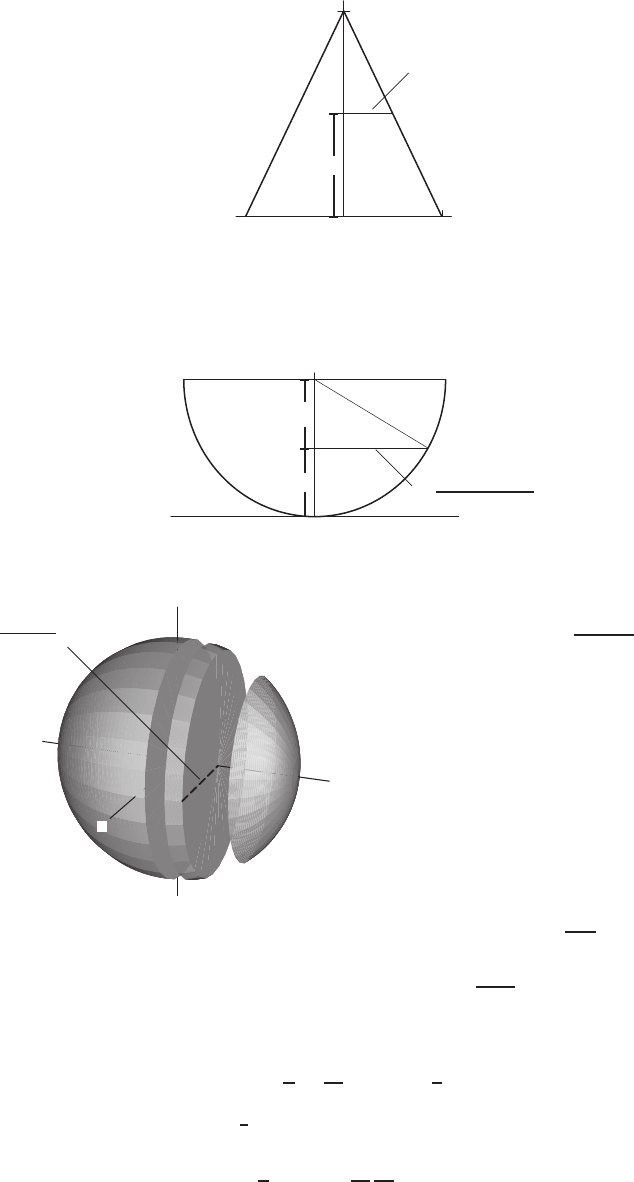
8.1 SOLUTIONS 721
30. Cone with height 6 and radius 3. See Figure 8.18.
3
✻
❄
y
6
✠
3−y/2
y
Figure 8.18
31. Hemisphere with radius 2. See Figure 8.19.
✻
❄
y
✻
❄
(2 −y)
2
2
■
p22−(2 −y)2
y
Figure 8.19
32.
x
y
❘
Radius =
√r2−x2
We slice up the sphere in planes perpen-
dicular to the x-axis. Each slice is a cir-
cle, with radius y=√r2−x2; that’s
the radius because x2+y2=r2when
z= 0. Then the volume is
V≈Xπ(y2)∆x=Xπ(r2−x2) ∆x.
Therefore, as ∆xtends to zero, we get
V=Zx=r
x=−r
π(r2−x2)dx
= 2 Zx=r
x=0
π(r2−x2)dx
= 2 πr2x−πx3
3
r
0
=4πr3
3.
33. We slice the cone horizontally into cylindrical disks with radius rand thickness ∆h. See Figure 8.20. The volume of each
disk is πr2∆h. We use the similar triangles in Figure 8.21 to write ras a function of h:
r
h=3
12 so r=1
4h.
The volume of the disk at height his π(1
4h)2∆h. To find the total volume, we integrate this quantity from h= 0 to
h= 12.
V=Z12
0
π1
4h2
dh =π
16
h3
3
12
0
= 36π= 113.097 m3.
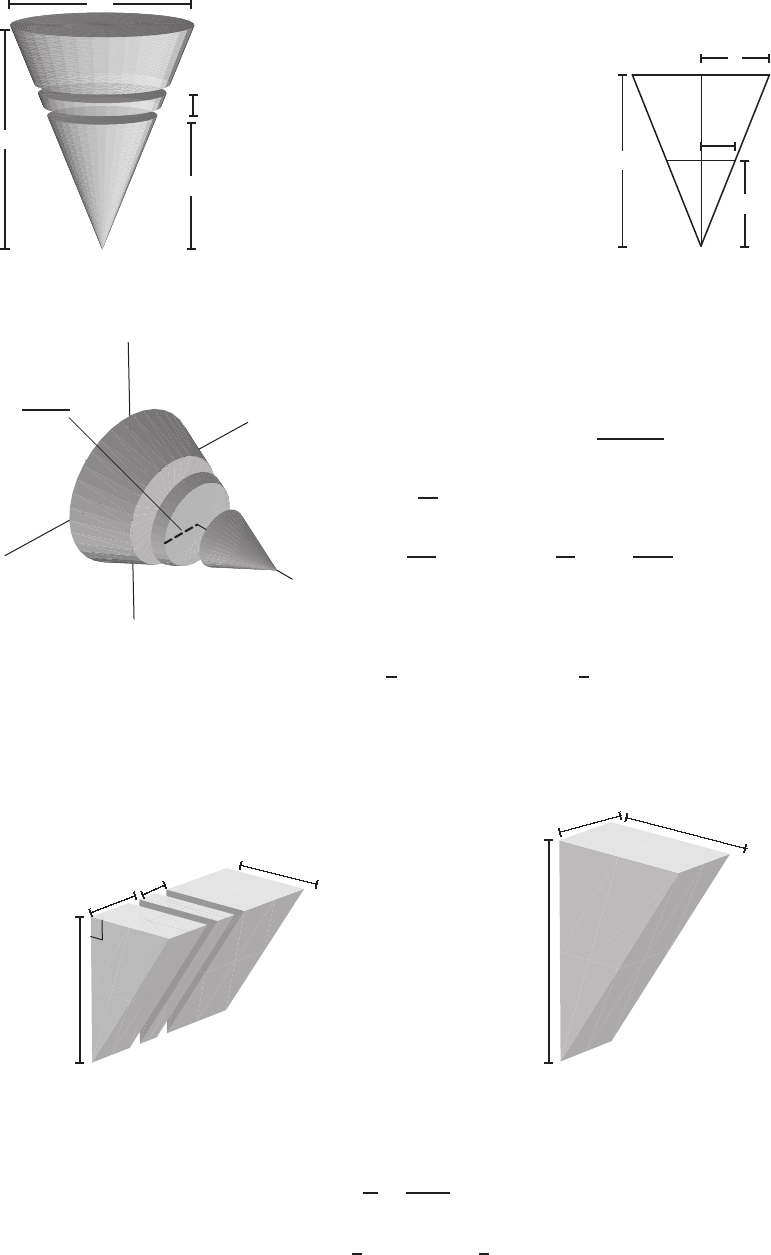
722 Chapter Eight /SOLUTIONS
✻
❄
12
m
✲✛ 6
m
✻
❄
∆h
✻
❄
h
Figure 8.20
✻
❄
12
m
✲✛r
✻
❄
h
✲✛ 3
Figure 8.21
34.
x
y
❘
Radius =
r(h−y)
h
This cone is what you get when you rotate the line x=r(h−
y)/h about the y–axis. So slicing perpendicular to the y–axis
yields
V=Zy=h
y=0
πx2dy =πZh
0(h−y)r
h2
dy
=πr2
h2Zh
0
(h2−2hy +y2)dy
=πr2
h2h2y−hy2+y3
3
h
0
=πr2h
3.
35. (a) A vertical slice has a triangular shape and thickness ∆x. See Figure 8.22.
Volume of slice =Area of triangle ·∆x=1
2Base ·Height ·∆x=1
2·2·3∆x= 3∆xcm3.
Thus,
Total volume = lim
∆x→0X3∆x=Z4
0
3dx = 3x
4
0
= 12 cm3.
✻
❄
3
cm
✛
✛
x
✛
✛
∆x
✛
✛
2
cm
✻
❄
3
cm
✛
✛
∆x
✛
✛
2
cm
Figure 8.22
(b) A horizontal slice has a rectangular shape and thickness ∆h. See Figure 8.23. Using similar triangles, we see that
w
2=3−h
3,
so
w=2
3(3 −h) = 2 −2
3h.

8.1 SOLUTIONS 723
Thus
Volume of slice ≈4w∆h= 4 2−2
3h∆h=8−8
3h∆h.
So,
Total volume = lim
∆h→0X8−8
3h∆h=Z3
08−8
3hdh =8h−4h2
3
3
0
= 12 cm3.
✻
❄
3
cm
✻
❄
h
✻
❄
∆h
✛
✛
4
cm
✛
✛
2
cm
✻
❄
∆h
✛
✛
w
✛
✛
4
cm
✛
✛
2
cm
w
2
✻
❄
h
✻
❄
3
Figure 8.23
36. We slice the water into horizontal slices, each of which is a rectangle. See Figure 8.24.
Volume of slice ≈150w∆hkm3.
To find win terms of h, we use the similar triangles in Figure 8.25:
w
3=h
0.2so w= 15h.
So
Volume of slice ≈150 ·15h∆h= 2250h∆hkm3.
Summing over all slices and letting ∆h→0gives
Total volume = lim
∆h→0X2250h∆h=Z0.2
0
2250h dh km3.
Evaluating the integral gives
Total volume = 2250 h2
2
0.2
0
= 45 km3.
✲✛ 3
km
✛
✛
150
km
w
Figure 8.24
✲✛
3 km
✻
❄
0.2
km
w
✻
❄
h
✻
❄
∆h
Figure 8.25
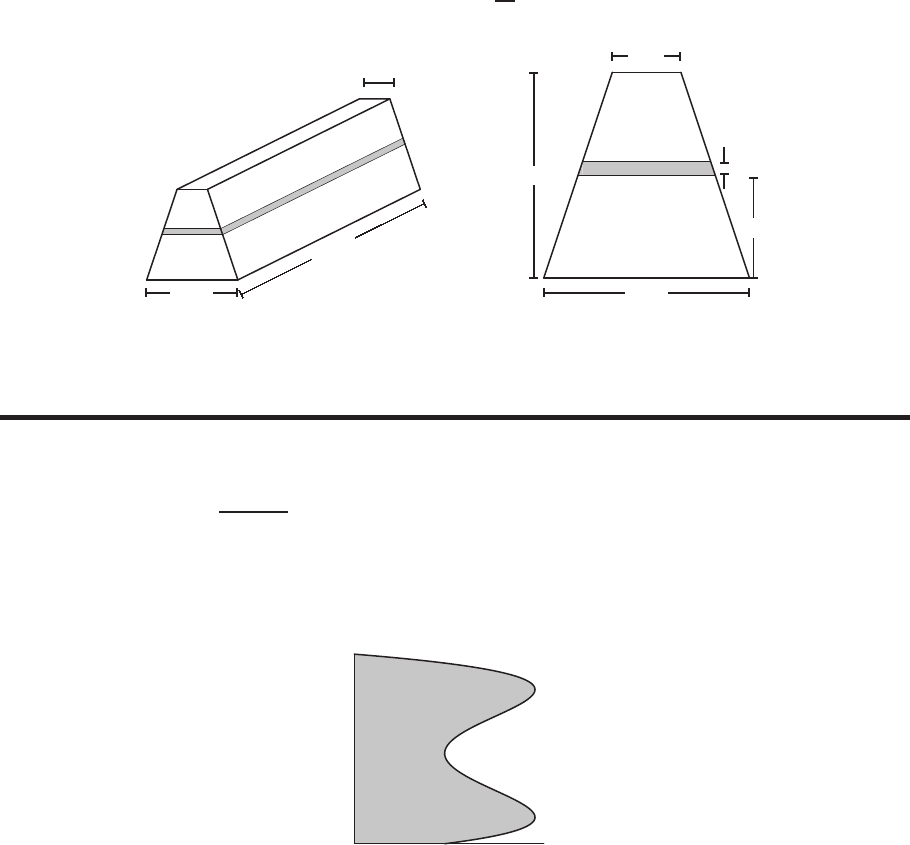
724 Chapter Eight /SOLUTIONS
37. To calculate the volume of material, we slice the dam horizontally. See Figure 8.26. The slices are rectangular, so
Volume of slice ≈1400w∆hm3.
Since wis a linear function of h, and w= 160 when h= 0, and w= 10 when h= 150, this function has slope =
(10 −160)/150 = −1. Thus
w= 160 −hmeters,
so
Volume of slice ≈1400(160 −h)∆hm3.
Summing over all slices and taking the limit as ∆h→0gives
Total volume = lim
∆h→0X1400(160 −h)∆h=Z150
0
1400(160 −h)dh m3.
Evaluating the integral gives
Total volume = 1400 160h−h2
2
150
0
=1.785 ·107m3.
✲✛ 160
m
✛
✛
1400
m
✲✛
10
m
w
Figure 8.26
✲✛ 160
m
✻
❄
150
m
✲✛10
m
✻
❄
∆h
✻
❄
h
w
Figure 8.27
Strengthen Your Understanding
38. The horizontal slice at height ygoes from x= 0 to a point on the line y= 2x. At this point, x=y/2. The correct
integral for the area is R8
0y/2dy.
39. Slice the sphere x2+y2= 102into slices of thickness ∆xperpendicular to the x-axis. The typical slice is approximately a
cylinder of radius y=√102−x2and height h= ∆x. The volume of the slice is approximately πy2h=π(102−x2)∆x.
The volume of the sphere is thus R10
−10π102−x2dx.
40. It would be hard to use vertical slices to find the area of the shaded region in Figure 8.28 because the vertical slices on the
right portion of the figure are in two pieces.
x
y
Figure 8.28
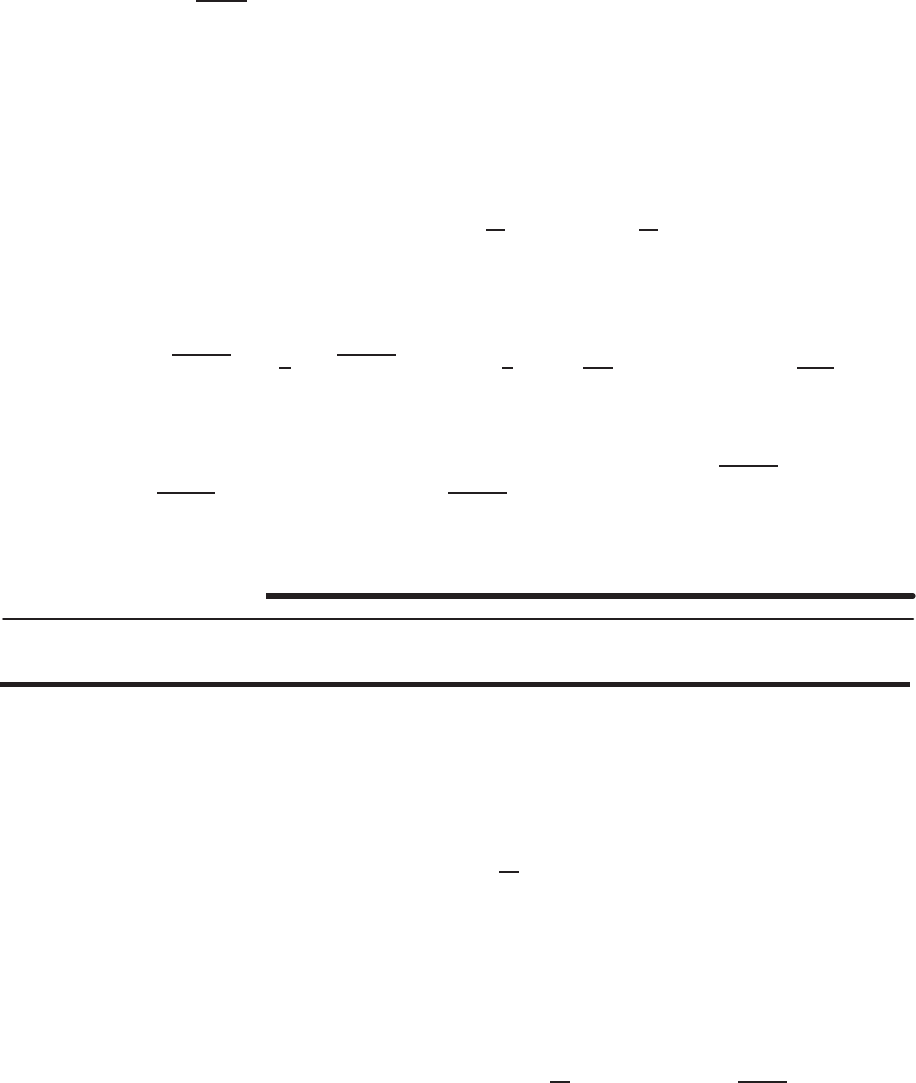
8.2 SOLUTIONS 725
41. One possible answer is the region between the positive x-axis, the positive y-axis and the line y= 1 −x. For horizontal
slices, the width of a slice at height yis x= 1 −y, and for vertical slices the height of a slice at position xis y= 1 −x.
42. True. Since y=±√9−x2represent the top and bottom halves of the sphere, slicing disks perpendicular to the x-axis
gives
Volume of slice ≈πy2∆x=π(9 −x2)∆x
Volume =Z3
−3
π(9−x2)dx.
43. False. Evaluating does not give the volume of a cone πr2h/3:
Zh
0
π(r−y)dy=πry −y2
2
h
0
=πrh −h2
2.
Alternatively, you can show by slicing that the integral representing this volume is Rh
0πr2(1 −y/h)2dy.
44. False. Using the table of integrals (VI-28 and VI-30) or a trigonometric substitution gives
Zr
0
πpr2−y2dy =π
2ypr2−y2+r2arcsin y
r
r
0
=πr2
2(arcsin 1 −arcsin 0) = π2r2
4.
The volume of a hemisphere is 2πr3/3.
Alternatively, you can show by slicing that the integral representing this volume is Rr
0π(r2−y2)dy.
45. True. Horizontal slicing gives rectangular slabs of length l, thickness ∆y, and width w= 2pr2−y2. So the volume of
one slab is 2lpr2−y2∆y, and the integral is Rr
−r2lpr2−y2dy.
Solutions for Section 8.2
Exercises
1. (a) The volume of a disk is given by
∆V≈π(2x)2∆x= 4πx2∆x,
so
Volume =Z3
0
4πx2dx.
(b) We have
Volume = 4πx3
3
3
0
= 36π.
2. (a) The volume of a disk is given by
∆V≈π(−x2+ 6x)2∆x,
so
Volume =Z6
0
π(−x2+6x)2dx.
(b) We have
Volume =Z6
0
π(x4−12x3+ 36x2)dx =πx5
5−3x4+ 12x3
6
0
=1296π
5.
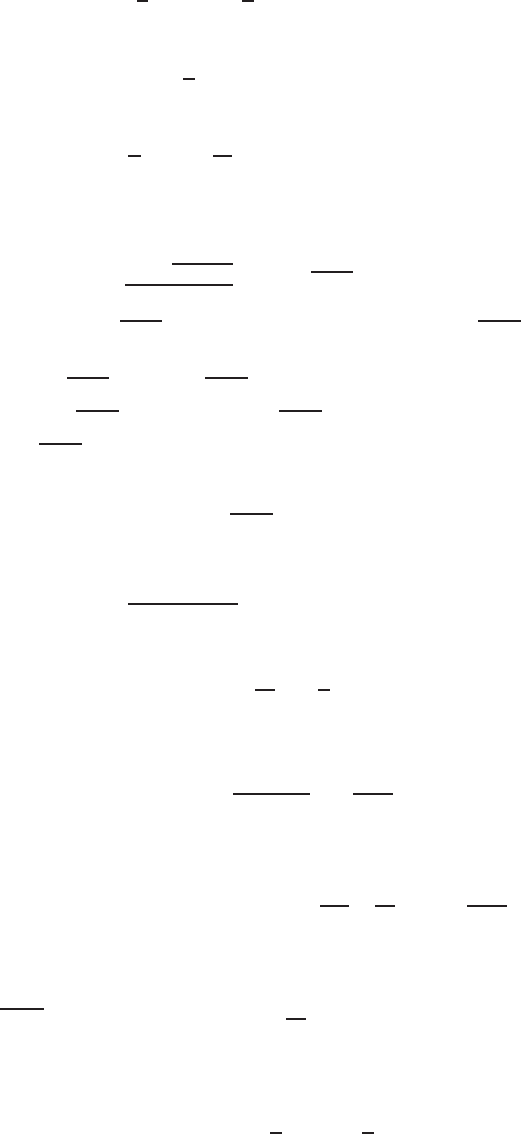
726 Chapter Eight /SOLUTIONS
3. (a) The strip stretches from x=y/2to x= 3. The volume of a disk with a hole in it is
∆V≈π32−y
22∆y=π
4(36 −y2) ∆y,
so
Volume =Z6
0
π
4(36 −y2)dy.
(b) We have
Volume =π
436y−y3
3
6
0
=36π.
4. (a) The equation y=−x2+ 6xcan be solved for xas
x2−6x+y= 0
x=6±√36 −4y
2= 3 ±p9−y.
The left end of the strip is given by x= 3 −√9−y, and the right end is given by x= 3 + √9−y. Thus, the
volume of a disk with a hole is
∆V≈π((3 + p9−y)2−(3 −p9−y)2) ∆y
=π((9 + 6p9−y+ 9 −y)−(9 −6p9−y+ 9 −y)) ∆y
= 12πp9−y∆y,
so
Volume = 12πZ9
0p9−y dy.
(b) We have
Volume =12π(9 −y)3/2
−3/2
9
0
= 216π.
5. The volume is given by
V=Z1
0
πy2dx =Z1
0
πx4dx =πx5
5
1
0
=π
5.
6. The volume is given by
V=Z2
1
πy2dx =Z2
1
π(x+ 1)4dx =π(x+ 1)5
5
2
1
=211π
5.
7. The volume is given by
V=Z0
−2
π(4−x2)2dx =πZ0
−2
(16 −8x2+x4)dx =π16x−8x3
3+x5
5
0
−2
=256π
15 .
8. The volume is given by
V=Z1
−1
π(√x+ 1)2dx =πZ1
−1
(x+ 1) dx =πx2
2+x
1
−1
= 2π.
9. The volume is given by
V=Z1
−1
πy2dx =Z1
−1
π(ex)2dx =Z1
−1
πe2xdx =π
2e2x
1
−1
=π
2(e2−e−2).
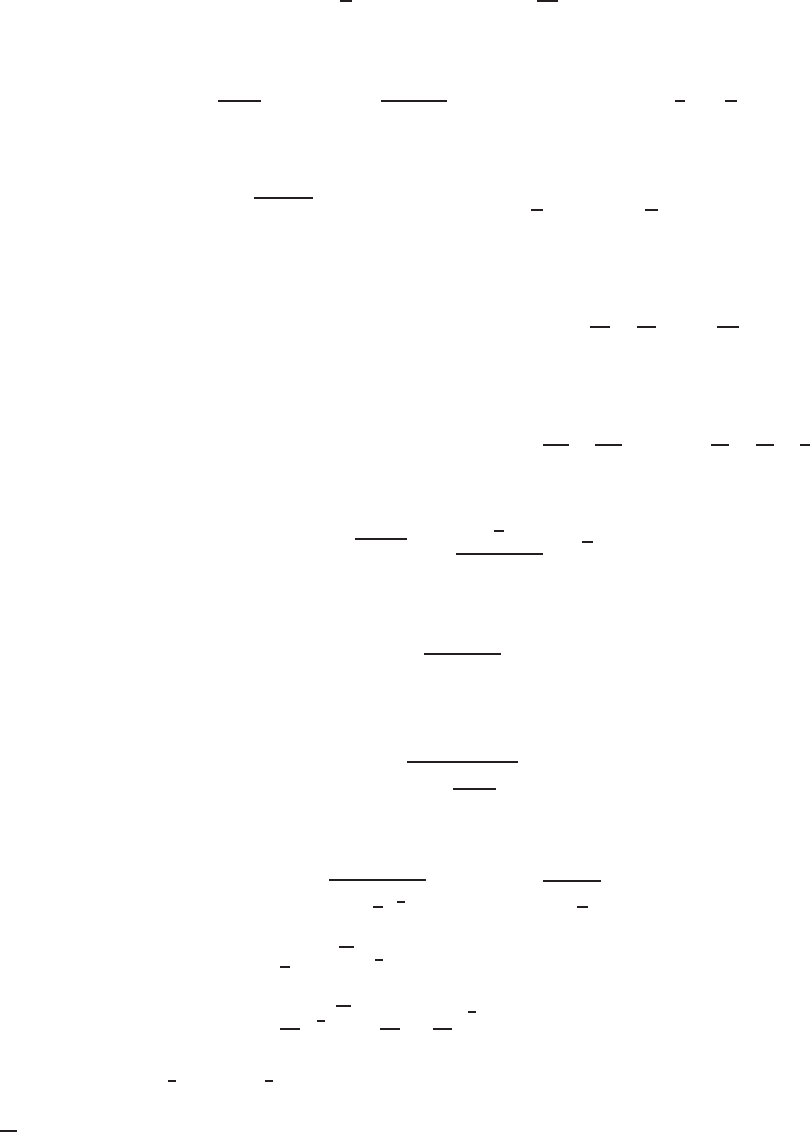
8.2 SOLUTIONS 727
10. The volume is given by
V=Zπ/2
0
πy2dx =Zπ/2
0
πcos2x dx.
Integration by parts gives
V=π
2(cos xsin x+x)
π/2
0
=π2
4.
11. The volume is given by
V=Z1
0
π1
x+ 1 2
dx =πZ1
0
dx
(x+ 1)2=−π(x+ 1)−1
1
0
=π1−1
2=π
2.
12. The volume is given by
V=πZ1
0
(√cosh 2x)2dx =πZ1
0
cosh 2x dx =π
2sinh 2x
1
0
=π
2sinh 2.
13. Since the graph of y=x2is below the graph of y=xfor 0≤x≤1, the volume is given by
V=Z1
0
πx2dx −Z1
0
π(x2)2dx =πZ1
0
(x2−x4)dx =πx3
3−x5
5
1
0
=2π
15 .
14. Since the graph of y=e3xis above the graph of y=exfor 0≤x≤1, the volume is given by
V=Z1
0
π(e3x)2dx−Z1
0
π(ex)2dx =Z1
0
π(e6x−e2x)dx =πe6x
6−e2x
2
1
0
=πe6
6−e2
2+1
3.
15. Since f′(x) = x, we evaluate the integral numerically or using the table to get
Arc length =Z2
0p1 + x2dx =ln(√5 + 2)
2+√5 = 2.958.
16. Since f′(x) = −sin x, we evaluate the integral numerically to get
Arc length =Z2
0p1 + sin2x dx = 2.508.
17. Since f′(x) = 1/(x+ 1), we evaluate the integral numerically to get
Arc length =Z2
0r1 + 1
x+ 1 2
dx = 2.302.
18. Note that this function is actually x3/2in disguise. So
L=Z2
0r1 + h3
2x1
2i2
dx =Zx=2
x=0 r1 + 9
4x dx
=4
9Zw=11
2
w=1
w1
2dw
=8
27 w3
2
11
2
1
=8
27 11
23
2−1≈3.526,
where we set w= 1 + 9
4x, so dx =4
9dw.
19. This is a one-quarter of the circumference of a circle of radius 2. That circumference is 2·2π= 4π, so the length is
4π
4=π.
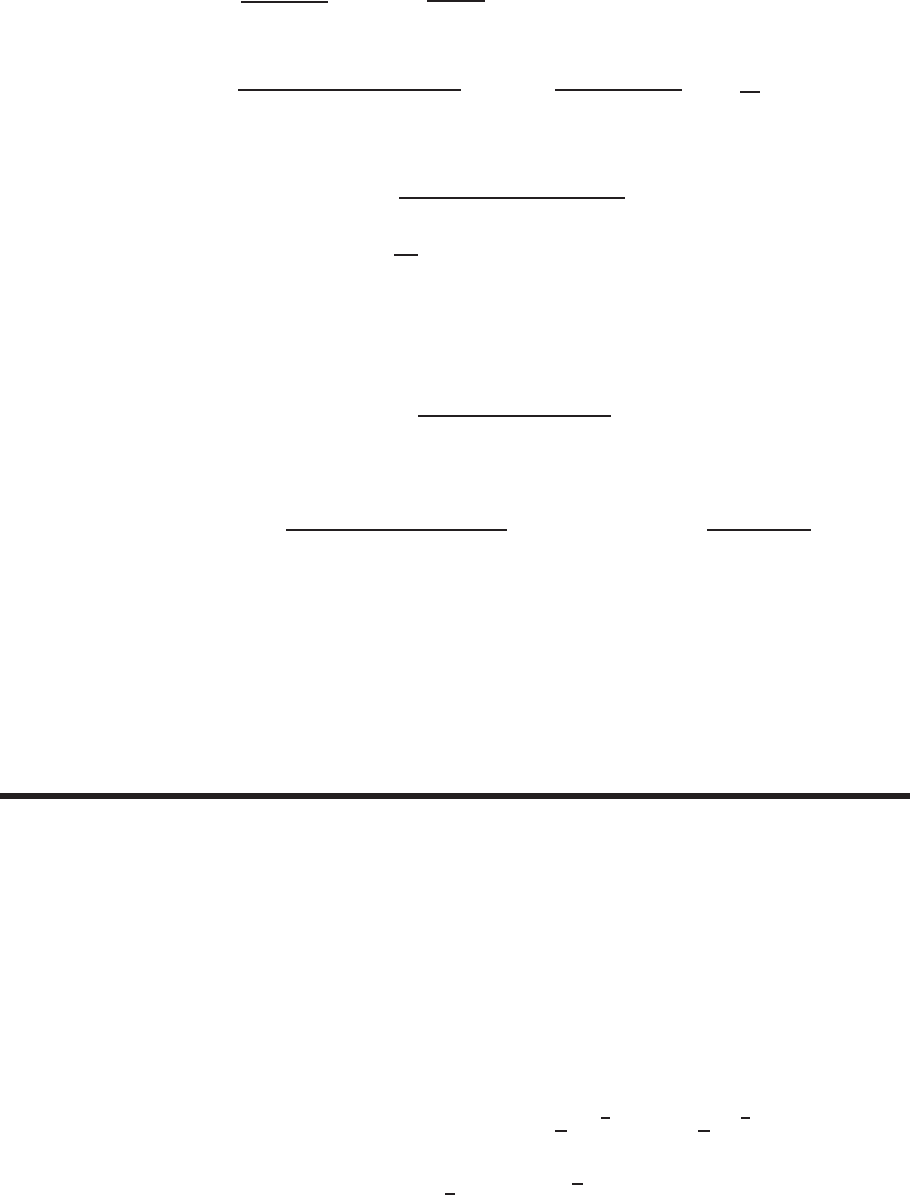
728 Chapter Eight /SOLUTIONS
20. Since f′(x) = sinh x, the arc length is given by
L=Z2
0p1 + sinh2x dx =Z2
0pcosh2x dx =Z2
0
cosh x dx = sinh x
2
0
= sinh 2.
21. The length is Z2
1p(x′(t))2+ (y′(t))2+ (z′(t))2dt =Z2
1p52+ 42+ (−1)2dt =√42.
This is the length of a straight line from the point (8,5,2) to (13,9,1).
22. We have
D=Z1
0p(−etsin(et))2+ (etcos(et))2dt
=Z1
0
√e2tdt =Z1
0
etdt
=e−1.
This is the length of the arc of a unit circle from the point (cos 1,sin 1) to (cos e, sin e)—in other words between the
angles θ= 1 and θ=e. The length of this arc is (e−1).
23. We have
D=Z2π
0p(−3 sin 3t)2+ (5 cos 5t)2dt.
We cannot find this integral symbolically, but numerical methods show D≈24.6.
24. Since dx/dt =−3 cos2tsin t,dy/dt = 3 sin2tcos t, we have
Arc length =Z2π
0p9 cos4tsin2t+ 9 sin4tcos2t dt = 3 Z2π
0|cos tsin t|pcos2t+ sin2t dt
= 3 Z2π
0|cos tsin t|dt.
We calculate the integral over the interval 0≤t≤π/2, where both cos tand sin tare positive, and multiply by 4:
Arc length = 12 Zπ/2
0
cos tsin t dt = 6 sin2t
π/2
0
= 6.
Problems
25. The two functions intersect at (0,0) and (8,2). We slice the volume with planes perpendicular to the line x= 9. This
divides the solid into thin washers with volume
Volume of slice =πr2
out∆y−πr2
in∆y.
The outer radius is the horizontal distance from the line x= 9 to the curve x=y3, so rout = 9 −y3. Similarly, the inner
radius is the horizontal distance from the line x= 9 to the curve x= 4y, so rin = 9 −4y. Integrating from y= 0 to
y= 2 we have
V=Z2
0
[π(9−y3)2−π(9 −4y)2]dy.
26. The two functions intersect at (0,0) and (8,2). We slice the volume with planes perpendicular to the line y= 3. This
divides the solid into thin washers with
Volume of slice =πr2
out∆x−πr2
in∆x.
The outer radius is the vertical distance from the line y= 3 to the curve y=1
4x, so rout = 3 −1
4x. Similarly, the inner
radius is the vertical distance from the line y= 3 to the curve y=3
√x, so rin = 3 −3
√x. Integrating from x= 0 to
x= 8 we have
V=Z8
0hπ(3 −1
4x)2−π(3 −3
√x)2idx.

8.2 SOLUTIONS 729
27. Note that the lines x= 9 and y=1
3xintersect at (9,3). We slice the volume with planes that are perpendicular to the
line y=−2. This divides the solid into thin washers with
Volume of slice =πr2
out∆x−πr2
in∆x.
Note that the inner radius is the vertical distance from the line y=−2to the x-axis, so rin = 2. Similarly, the outer
radius is the vertical distance from the line y=−2to the line y=1
3x, so rout = 2 + 1
3x. Integrating from x= 0 to
x= 9 we have
V=Z9
0hπ(2 + 1
3x)2−π22idx.
28. Note that the lines x= 9 and y=1
3xintersect at (9,3). We slice the volume with planes that are perpendicular to the
line x=−1. This divides the solid into thin washers with
Volume of slice =πr2
out∆y−πr2
in∆y.
Note that the inner radius is the horizontal distance from the line x=−1to the line x= 3y, so rin = 1 + 3y. Similarly,
the outer radius is the horizontal distance from the line x=−1to the line x= 9, so rout = 1 + 9. Integrating from
y= 0 to y= 3 we have
V=Z3
0
[π(1 + 9)2−π(1 + 3y)2]dy.
29. The two functions intersect at (0,0) and (5,25). We slice the volume with planes perpendicular to the x-axis. This divides
the solid into thin washers with volume
Volume of slice =π((rout)2−(rin)2)∆x.
The outer radius is the vertical distance from the x-axis to the curve y= 5x, so rout = 5x. Similarly, the inner radius is
the vertical distance from the x-axis to the curve y=x2, so rin =x2. Integrating from x= 0 to x= 5 we have
V=Z5
0
π((5x)2−(x2)2)dx.
30. The two functions intersect at (0,0) and (5,25). We slice the volume with planes perpendicular to the y-axis. This divides
the solid into thin washers with volume
Volume of slice =π((rout)2−(rin)2)∆y.
The outer radius is the horizontal distance from the y-axis to the curve x=√y, so rout =√y. Similarly, the inner radius
is the horizontal distance from the y-axis to the curve x=y/5, so rin =y/5. Integrating from y= 0 to y= 25 we have
V=Z25
0
π((√y)2−(y/5)2)dy.
31. The two functions intersect at (0,0) and (5,25). We slice the volume with planes perpendicular to the horizontal line
y=−4. This divides the solid into thin washers with volume
Volume of slice =π((rout)2−(rin)2)∆x.
The outer radius is the vertical distance from the line y=−4to the curve y= 5x, so rout = 4 + 5x. Similarly, the inner
radius is the vertical distance from the line y=−4to the curve y=x2, so rin = 4 + x2. Integrating from x= 0 to
x= 5 we have
V=Z5
0
π((4 + 5x)2−(4 + x2)2)dx.
32. The two functions intersect at (0,0) and (5,25). We slice the volume with planes perpendicular to the vertical line
x=−3. This divides the solid into thin washers with volume
Volume of slice =π((rout)2−(rin)2)∆y.
The outer radius is the horizontal distance from the line x=−3to the curve x=√y, so rout = 3 + √y. Similarly, the
inner radius is the horizontal distance from the line x=−3to the curve x=y/5, so rin = 3 + y/5. Integrating from
y= 0 to y= 25 we have
V=Z25
0
π((3 + √y)2−(3 + y/5)2)dy.
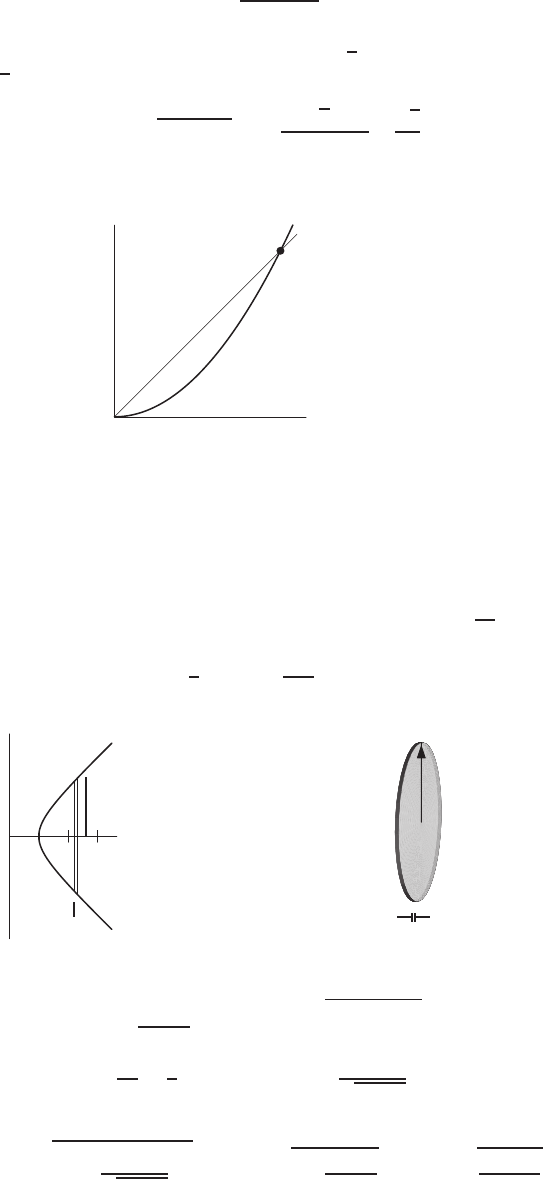
730 Chapter Eight /SOLUTIONS
33. One arch of the sine curve lies between x= 0 and x=π. Since d(sin x)/dx = cos x, evaluating the integral numerically
gives
Arc length =Zπ
0p1 + cos2x dx = 3.820.
34. The curves cross at (1,1); see Figure 8.29. The straight side has length √2 = 1.414; as this is the hypotenuse of a right
triangle with sides 1,1,√2. The curved side has
Arc length =Z1
0p1 + (2x)2dx =ln(√5 + 2)
4+√5
2= 1.479.
Thus the perimeter is 1.4142 + 1.479 = 2.893.
(1,1)
y=x
y=x2
x
y
Figure 8.29
35. (a) Slicing the region perpendicular to the x-axis gives disks of radius y. See Figure 8.30.
Volume of slice ≈πy2∆x=π(x2−1)∆x.
Thus,
Total volume = lim
∆x→0Xπ(x2−1)∆x=Z3
2
π(x2−1) dx =πx3
3−x
3
2
=π9−3−8
3−2=16π
3.
12 3
✻
❄
y
✻
∆x
x2−y2= 1
x
y
y
✲ ✛
∆x
Figure 8.30
(b) The arc length, L, of the curve y=f(x)is given by L=Rb
ap1 + (f′(x))2dx. In this problem yis an implicit
function of x. Solving for ygives y=√x2−1as the equation of the top half of the hyperbola. Differentiating gives
dy
dx =1
2(x2−1)−1/2(2x) = x
√x2−1.
Thus
Arc length =Z3
2s1 + x
√x2−12
dx =Z3
2r1 + x2
x2−1dx =Z3
2r2x2−1
x2−1dx = 1.48.
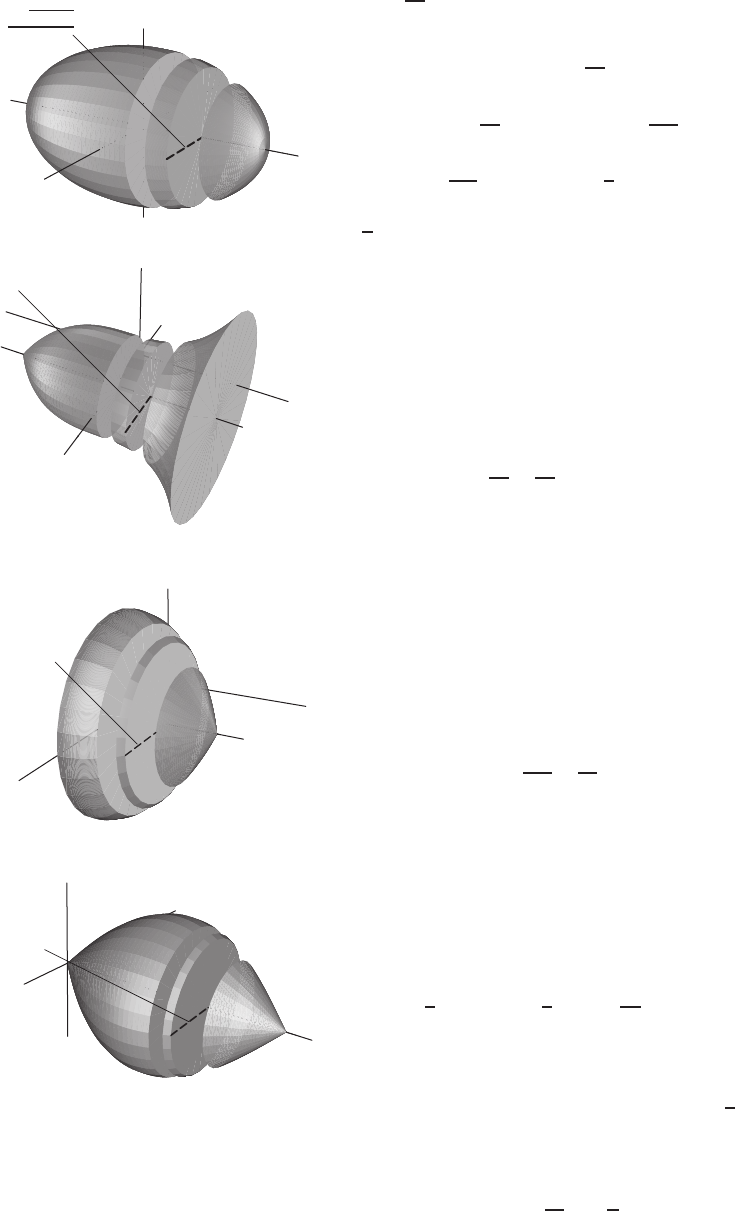
8.2 SOLUTIONS 731
36. z
x
y
❘
Radius
=b√a2−x2
a
y2=b21−x2
a2.
V=Za
−a
πy2dx =πZa
−a
b21−x2
a2dx
= 2πb2Za
01−x2
a2dx = 2πb2x−x3
3a2a
0
= 2πb2a−a3
3a2= 2πb2a−1
3a
=4
3πab2.
37.
x
y
(y=−1)
❘
Radius
= 1 + x3We slice the region perpendicular to the x–axis. The Rie-
mann sum we get is Pπ(x3+ 1)2∆x. So the volume Vis
the integral
V=Z1
−1
π(x3+1)2dx
=πZ1
−1
(x6+ 2x3+ 1) dx
=πx7
7+x4
2+x
1
−1
= (16/7)π≈7.18.
38.
x
y
z
(x= 1)
❘
Radius
= 1 −x
We slice the region perpendicular to the y–axis. The Rie-
mann sum we get is Pπ(1 −x)2∆y=Pπ(1 −y2)2∆y.
So the volume Vis the integral
V=Z1
0
π(1−y2)2dy
=πZ1
0
(1 −2y2+y4)dy
=πy−2y3
3+y5
5
1
0
= (8/15)π≈1.68.
39.
x
y
z
❥
Radius
= sin x
We take slices perpendicular to the x–axis. The Riemann
sum for approximating the volume is Pπsin2x∆x. The
volume is the integral corresponding to that sum, namely
V=Zπ
0
πsin2x dx
=πh−1
2sin xcos x+1
2xi
π
0
=π2
2≈4.935.
40. Slice the object into disks horizontally, as in Figure 8.31. A typical disk has thickness ∆yand radius x=√y. Thus
Volume of slice ≈πx2∆y=πy ∆y.
Volume of solid = lim
∆y→0Xπy ∆y=Z1
0
πy dy =πy2
2
1
0
=π
2.
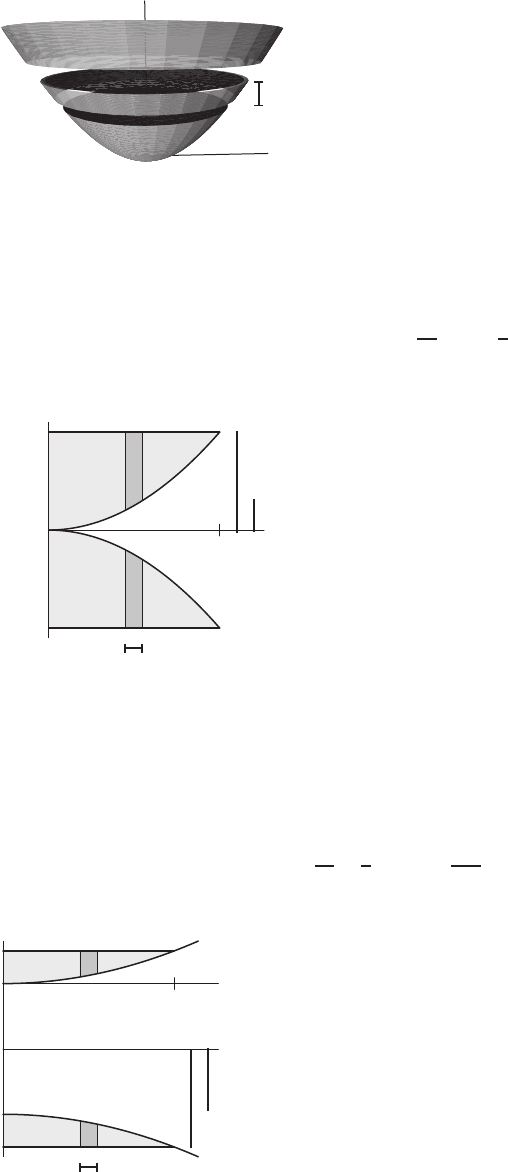
732 Chapter Eight /SOLUTIONS
x
✻
❄
∆y
y
1y=x2
Figure 8.31
41. Slice the object into rings vertically, as is Figure 8.32. A typical ring has thickness ∆xand outer radius y= 1 and inner
radius y=x2.
Volume of slice ≈π12∆x−πy2∆x=π(1 −x4) ∆x.
Volume of solid = lim
∆x→0Xπ(1−x4) ∆x=Z1
0
π(1−x4)dx =πx−x5
5
1
0
=4
5π.
1
−1
1
✲✛
∆x
Inner radius
✻
Outer radius
✻
y=x2
x
y
Figure 8.32
: Cross-section of solid
42. The region is cylindrical with a hole around the axis of rotation, y=−2. Slice it into rings vertically, as in Figure 8.33.
A typical ring has thickness ∆xand outer radius 1 + 2 = 3 and inner radius y+ 2 = x2+ 2. Thus
Volume of slice ≈π32∆x−π(x2+ 2)2∆x=π(5 −x4−4x2) ∆x.
Volume of solid =Z1
0
π(5−x4−4x2) ∆x=π5x−x5
5−4
3x3
1
0
=52π
15 .
1
−5
−4
−2
1
✲✛
∆x
Inner radius
❄
Outer radius
❄
y=x2
Axis of rotation:
y=−2
x
y
Figure 8.33
: Cross-section of solid
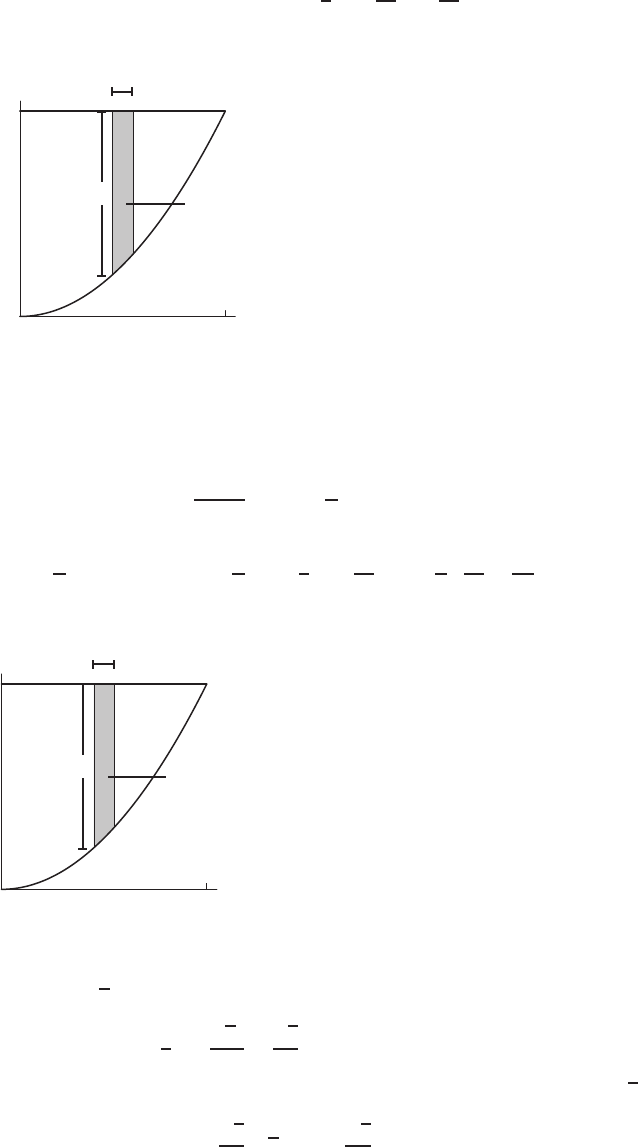
8.2 SOLUTIONS 733
43. Slicing perpendicularly to the x-axis gives squares whose thickness is ∆xand whose side is 1−y= 1 −x2. See
Figure 8.34. Thus
Volume of square slice ≈(1 −x2)2∆x= (1 −2x2+x4) ∆x.
Volume of solid =Z1
0
(1−2x2+x4)dx =x−2
3x3+x5
5
1
0
=8
15 .
1
1
✲✛
∆x
✛
Base of square (standing on paper)
✻
❄
1−y
y=x2
x
y
Figure 8.34
: Base of solid
44. Slicing perpendicularly to the x-axis gives semicircles whose thickness is ∆xand whose diameter is 1−y= 1 −x2. See
Figure 8.35. Thus
Volume of semicircular slice ≈π1−x2
22
∆x=π
4(1 −2x2+x4) ∆x.
Volume of solid =Z1
0
π
4(1 −2x2+x4)dx =π
4x−2
3x3+x5
5
1
0
=π
4·8
15 =2π
15 .
1
1
✲✛
∆x
✛
Diameter of semicircle (standing on paper)
✻
❄
1−y
y=x2
x
y
Figure 8.35
: Base of solid
45. An equilateral triangle of side shas height √3s/2and
Area =1
2·s·√3s
2=√3
4s2.
Slicing perpendicularly to the y-axis gives equilateral triangles whose thickness is ∆yand whose side is x=√y.
See Figure 8.36. Thus
Volume of triangular slice ≈√3
4(√y)2∆y=√3
4y∆y.
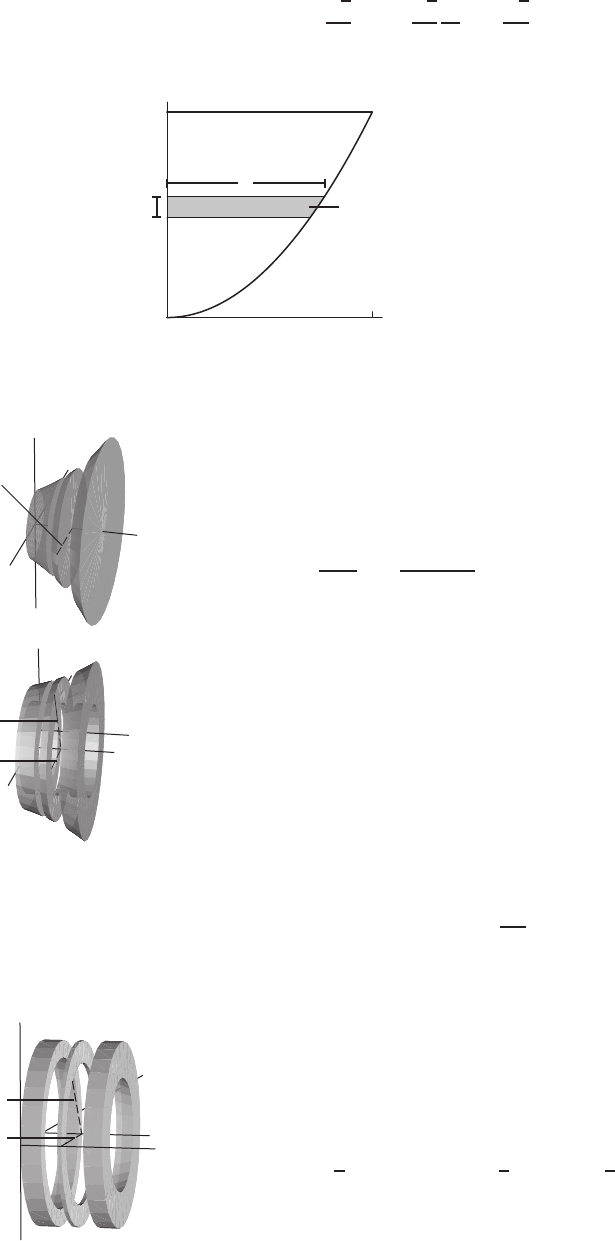
734 Chapter Eight /SOLUTIONS
Volume of solid =Z1
0
√3
4y dy =√3
4
y2
2
1
0
=√3
8.
1
1
✻
❄
∆y✛
Base of triangle (standing on paper)
✲✛ x
y=x2
x
y
Figure 8.36
: Base of solid
46.
x
y
z
❘
r=ex
This is the volume of revolution gotten from the rotating the
curve y=ex. Take slices perpendicular to the x-axis. They
will be circles with radius ex, so
V=Zx=1
x=0
πy2dx =πZ1
0
e2xdx
=πe2x
2
1
0
=π(e2−1)
2≈10.036.
47.
x
y
✲
rout =ex
✲
rin = 3 (y=−3)
We slice the volume with planes perpendicular to the line y=
−3.This divides the curve into thin washers, as in Example 3 on
page 424 of the text, whose volumes are
πr2
outdx −πr2
indx =π(3 + y)2dx −π32dx.
So the integral we get from adding all these washers up is
V=Zx=1
x=0
[π(3 + y)2−π32]dx
=πZ1
0
[(3 + ex)2−9] dx
=πZ1
0
[e2x+6ex]dx =π[e2x
2+ 6ex]
1
0
=π[(e2/2 + 6e)−(1/2 + 6)] ≈42.42.
48.
x
y
z
✲
rout = 7
✲
rin = 7 −ex
(y= 7)
This problem can be done by slicing the volume into washers
with planes perpendicular to the axis of rotation, y= 7, just like
in Example 3. This time the outside radius of a washer is 7, and
the inside radius is 7−ex. Therefore, the volume Vis
V=Zx=1
x=0
[π72−π(7 −ex)2]dx =πZ1
0
(14ex−e2x)dx
=πh14ex−1
2e2xi
1
0
=πh14e−1
2e2−14 −1
2i
≈65.54.
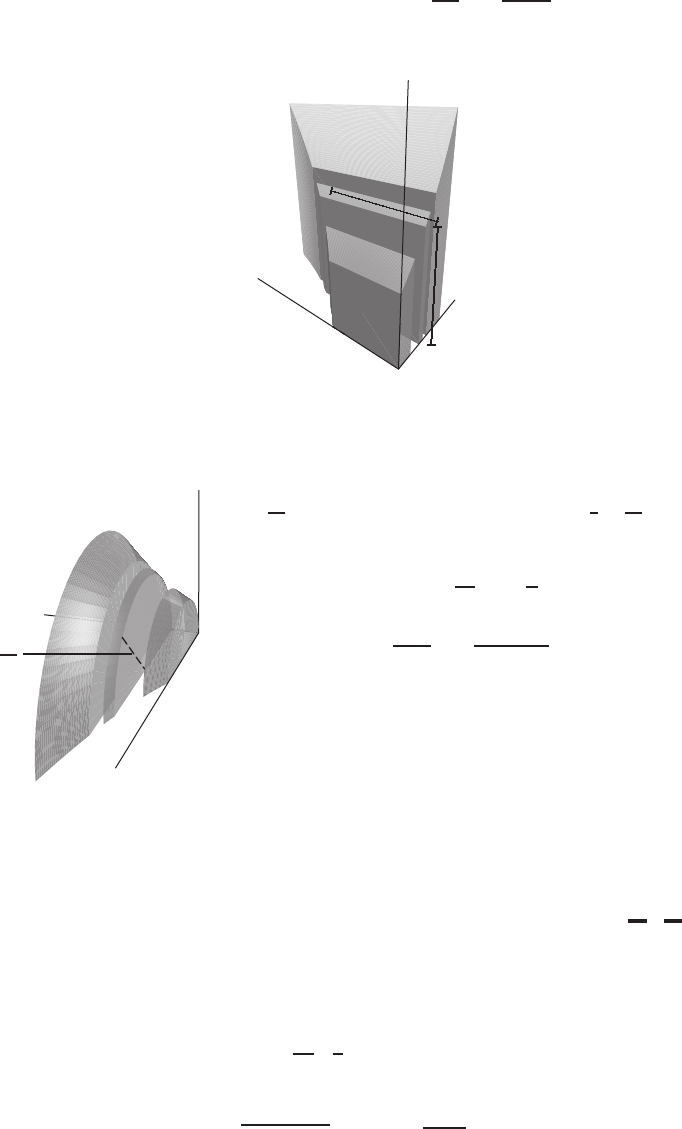
8.2 SOLUTIONS 735
49. We now slice perpendicular to the x-axis. As stated in the problem, the cross-sections obtained thereby will be squares,
with base length ex. The volume of one square slice is (ex)2dx. (See Figure 8.37.) Adding the volumes of the slices
yields
Volume = Zx=1
x=0
y2dx =Z1
0
e2xdx =e2x
2
1
0
=e2−1
2= 3.195.
x
y
z
✛
✛
ex
✛
✛
ex
Figure 8.37
50.
x
y
z
✲
r=ex
2
We slice perpendicular to the x-axis. As stated in the problem,
the cross-sections obtained thereby will be semicircles, with ra-
dius ex
2. The volume of one semicircular slice is 1
2πex
22dx.
(Look at the picture.) Adding up the volumes of the slices yields
Volume = Zx=1
x=0
πy2
2dx =π
8Z1
0
e2xdx
=πe2x
16
1
0
=π(e2−1)
16 ≈1.25.
51. If we revolve the region 0≤y≤g(x)around the x-axis, the volume of the resulting solid is given by Zπ
0
π(g(x))2dx.
Taking the hint, we can write our integral in this form:
Zπ
0
π(4 −4 cos2x)dx =Zπ
0
4π1−cos2xdx =Zπ
0
4πsin2x dx =Zπ
0
π(2 sin x)2
| {z }
(g(x))2
dx.
Therefore, g(x) = 2 sin xor g(x) = −2 sin x.
52. At time t= 6, the particle has traveled 3·6 = 18 cm. Suppose it is then at the point x=b. Then the arc length from the
origin to this point is 18 cm. Since
d
dx 2
3x3/2=x1/2,
we have
Arc length =Zb
0p1 + (x1/2)2dx =Zb
0
√1 + x dx = 18
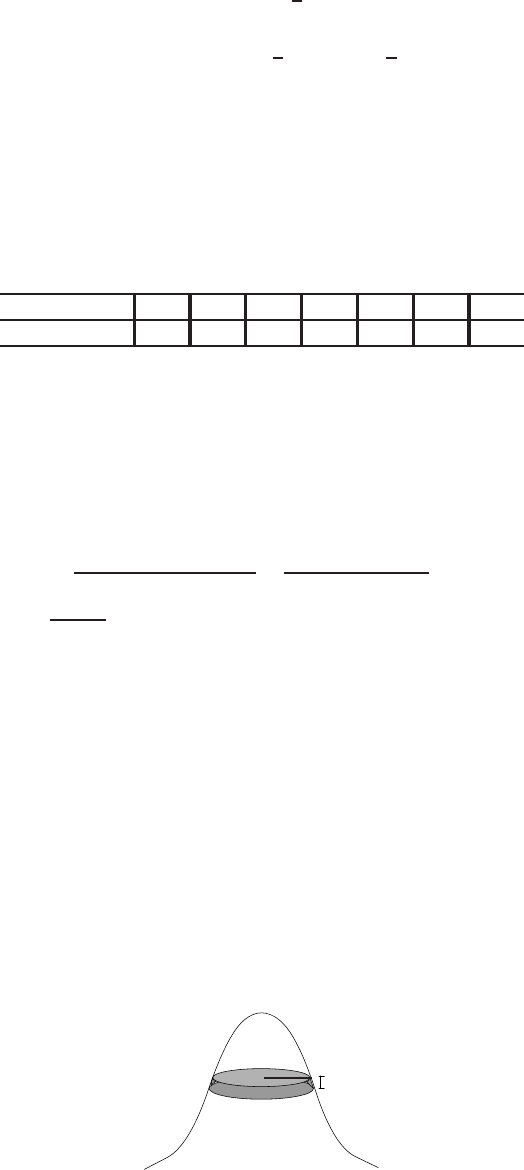
736 Chapter Eight /SOLUTIONS
2
3(1 + x)3/2
b
0
= 18
2
3(1 + b)3/2−2
3= 18
(1 + b)3/2= 28
b= 282/3−1 = 8.221.
When x= 8.221,y= 15.714.
53. We want to approximate R120
0A(h)dh, where his height, and A(h)represents the cross-sectional area of the trunk at
height h. Since A=πr2(circular cross-sections), and c= 2πr, where cis the circumference, we have A=πr2=
π[c/(2π)]2=c2/(4π). We make a table of A(h)based on this:
Table 8.1
height (feet) 0 20 40 60 80 100 120
Area (square feet) 53.79 38.52 28.73 15.60 2.865 0.716 0.080
We now form left & right sums using the chart:
LEFT(6) = 53.79 ·20 + 38.52 ·20 + 28.73 ·20 + 15.60 ·20 + 2.865 ·20 + 0.716 ·20
= 2804.42.
RIGHT(6) = 38.52 ·20 + 28.73 ·20 + 15.60 ·20 + 2.865 ·20 + 0.716 ·20 + 0.080 ·20
= 1730.22
So
TRAP(6) = RIGHT(6) + LEFT(6)
2=2804.42 + 1730.22
2= 2267.32 cubic feet.
54. If y=e−x2/2, then x=√−2 ln y. (Note that since 0< y ≤1,ln y≤0.) A typical slice has thickness ∆yand radius
x. See Figure 8.38. So
Volume of slice =πx2∆y=−2πln y∆y.
Thus,
Total volume =−2πZ1
0
lny dy.
Since ln yis not defined at y= 0, this is an improper integral:
Total Volume =−2πZ1
0
ln y dy =−2πlim
a→0Z1
a
ln y dy
=−2πlim
a→0(yln y−y)
1
a
=−2πlim
a→0(−1−aln a+a).
By looking at the graph of xln xon a calculator, we see that lim
a→0aln a= 0. Thus,
Total volume =−2π(−1) = 2π.
✲
x
∆y
Figure 8.38
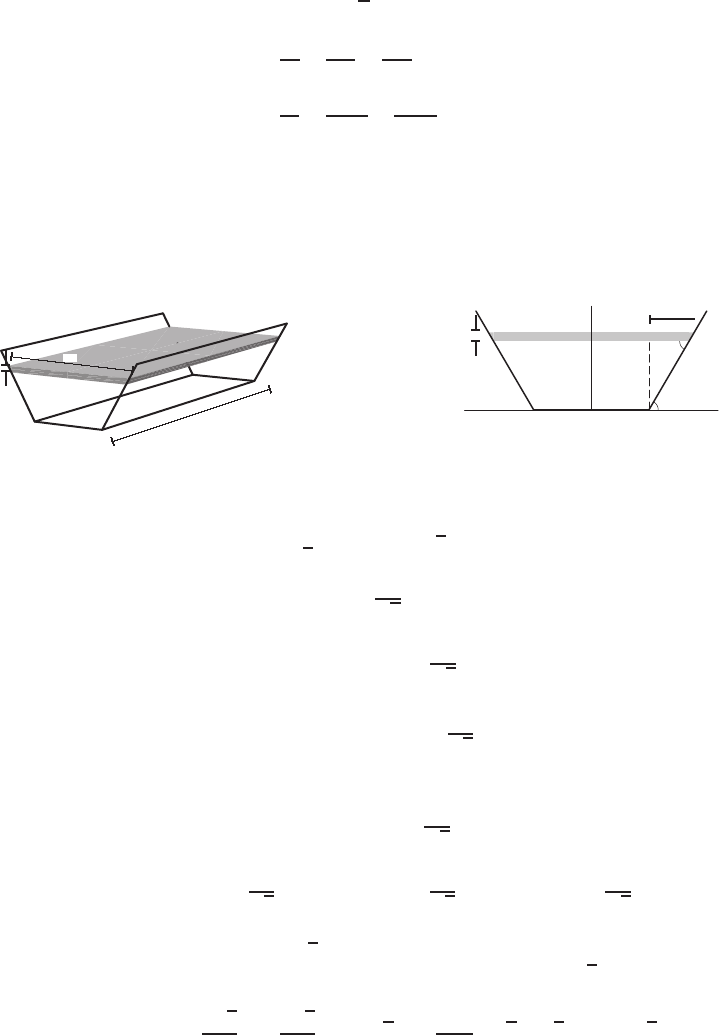
8.2 SOLUTIONS 737
55. (a) We can begin by slicing the pie into horizontal slabs of thickness ∆hlocated at height h. To find the radius of each
slice, we note that radius increases linearly with height. Since r= 4.5when h= 3 and r= 3.5when h= 0, we
should have r= 3.5 + h/3. Then the volume of each slab will be πr2∆h=π(3.5 + h/3)2∆h. To find the total
volume of the pie, we integrate this from h= 0 to h= 3:
V=πZ3
03.5+h
32
dh
=πh3
27 +7h2
6+49h
4
3
0
=π33
27 +7(32)
6+49(3)
4≈152 in3.
(b) We use 1.5in as a rough estimate of the radius of an apple. This gives us a volume of (4/3)π(1.5)3≈10 in3. Since
152/10 ≈15, we would need about 15 apples to make a pie.
56. (a) The volume can be computed by several methods, not all of them requiring integration. We will slice horizontally,
forming rectangular slabs of length 100 cm, height ∆y, width wand integrate. See Figure 8.39.
✛
✛
w
✛
✛
100
cm
✻
❄
∆y
Figure 8.39
✲✛ d
60◦
60◦
✻
❄
∆y
y
5
cm
x
y
Figure 8.40
From the right triangle, we see y
d= tan 60◦=√3
so
d=y
√3.
Thus
w= 5 + 2d= 5 + 2y
√3.
The volume of the slab is
∆V≈100w∆y= 100 5 + 2y
√3∆y,
so the total volume is given by
Volume = lim
∆y→0X∆V=lim
∆y→0X100 5 + 2y
√3∆y
=Zh
0
100 5 + 2y
√3dy = 100 5y+y2
√3
h
0
=100 5h+h2
√3cm3.
(b) The maximum value of his h= 5 sin 60◦= 5√3/2cm ≈4.33 cm.
(c) The maximum volume of water that the gutter can hold is given by substituting h= 5√3/2into the volume:
Maximum volume = 100 5·5√3
2+5√3
22,√3!=2500
4(2√3 + √3) = 1875√3≈3247.6cm3.
(d) Because the gutter is narrower at the bottom than the top, if it is filled with half the maximum possible volume of
water, the gutter will be filled to a depth of more than half of 4.33 cm.
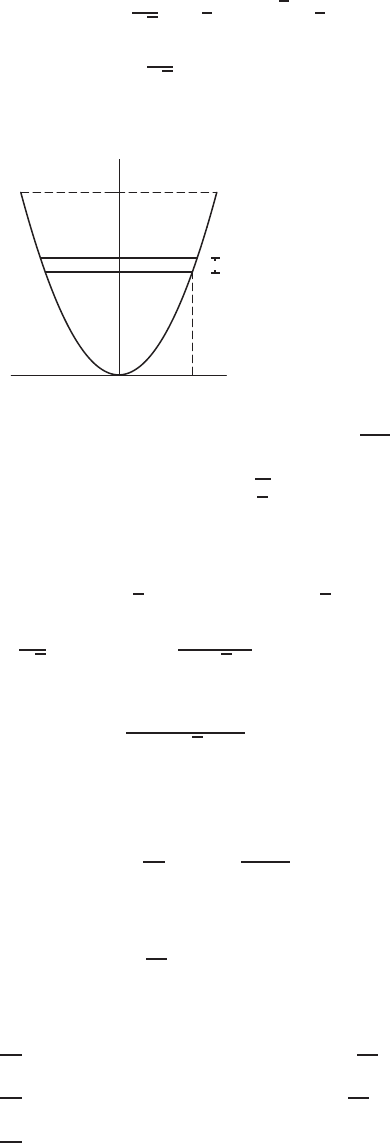
738 Chapter Eight /SOLUTIONS
(e) We want to solve for the value of hsuch that
Volume = 100 5h+h2
√3=1
2·1875√3 = 1
2Vmax
5h+h2
√3= 16.238.
Solving gives h= 2.52 and h=−11.18. Since only positive values of hare meaningful, h= 2.52 cm.
57.
x
Hy=ax2
x
y
✻
❄
∆y
We divide the interior of the boat into flat slabs of thickness ∆yand width 2x= 2py/a. (See above.) We have
Volume of slab ≈2xL∆y= 2Lqy
a∆y.
We are interested in the total volume of the region 0≤y≤H, so
Total volume = lim
∆y→0X2Ly
a(1/2)
∆y=ZH
0
2Ly
a(1/2)
dy
=2L
√aZH
0
y(1/2)dy =4LH(3/2)
3√a.
If Land Hare in meters,
Buoyancy force =40,000LH(3/2)
3√anewtons.
58. We can find the volume of the tree by slicing it into a series of thin horizontal cylinders of height dh and circumference
C. The volume of each cylindrical disk will then be
V=πr2dh =πC
2π2
dh =C2dh
4π.
Summing all such cylinders, we have the total volume of the tree as
Total volume =1
4πZ120
0
C2dh.
We can estimate this volume using a trapezoidal approximation to the integral with ∆h= 20:
LEFT estimate =1
4π[20(312+ 282+ 212+ 172+ 122+ 82)] = 1
4π(53660).
RIGHT estimate =1
4π[20(282+ 212+ 172+ 122+ 82+ 22)] = 1
4π(34520).
TRAP =1
4π(44090) ≈3509 cubic inches.
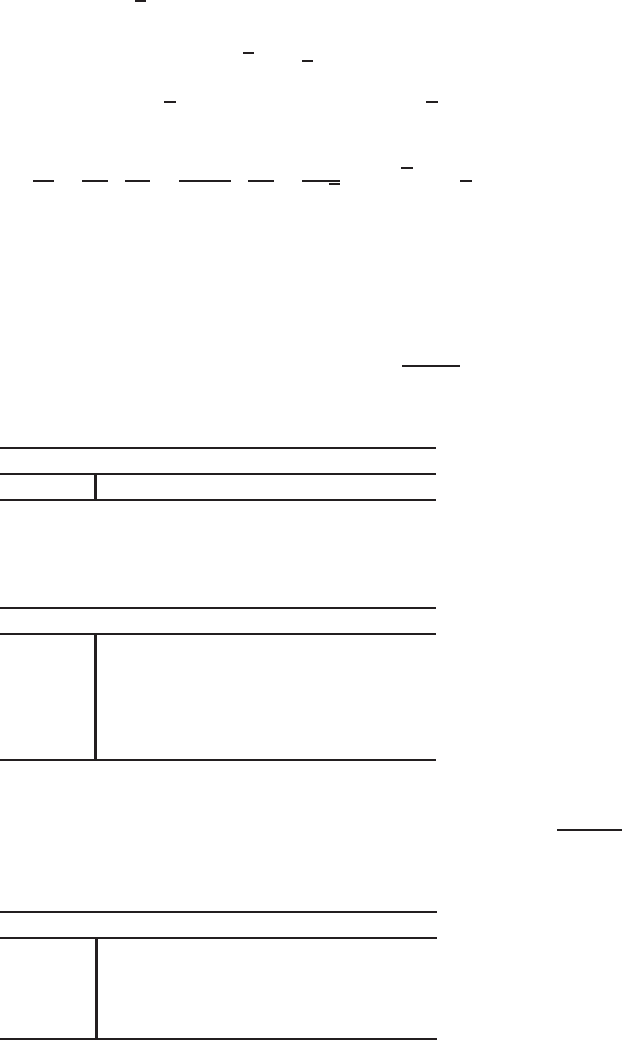
8.2 SOLUTIONS 739
59. (a) The volume, V, contained in the bowl when the surface has height his
V=Zh
0
πx2dy.
However, since y=x4, we have x2=√yso that
V=Zh
0
π√y dy =2
3πh3/2.
Differentiating gives dV /dh =πh1/2=π√h. We are given that dV /dt =−6√h, where the negative sign reflects
the fact that Vis decreasing. Using the chain rule we have
dh
dt =dh
dV ·dV
dt =1
dV /dh ·dV
dt =1
π√h·(−6√h) = −6
π.
Thus, dh/dt =−6/π, a constant.
(b) Since dh/dt =−6/π we know that h=−6t/π +C. However, when t= 0,h= 1, therefore h= 1 −6t/π. The
bowl is empty when h= 0, that is when t=π/6units.
60. The problem appears complicated, because we are now working in three dimensions. However, if we take one dimension
at a time, we will see that the solution is not too difficult. For example, let’s just work at a constant depth, say 0. We
apply the trapezoid rule to find the approximate area along the length of the boat. For example, by the trapezoid rule the
approximate area at depth 0from the front of the boat to 10 feet toward the back is (2+8)·10
2= 50.Overall, at depth 0we
have that the area for each length span is as follows:
Table 8.2
length span: 0–10 10–20 20–30 30–40 40–50 50–60
depth 0 50 105 145 165 165 130
We can fill in the whole chart the same way:
Table 8.3
length span: 0–10 10–20 20–30 30–40 40–50 50–60
0 50 105 145 165 165 130
2 25 60 90 105 105 90
depth 4 15 35 50 65 65 50
6 5 15 25 35 35 25
8 0 5 10 10 10 10
Now, to find the volume, we just apply the trapezoid rule to the depths and areas. For example, according to the
trapezoid rule the approximate volume as the depth goes from 0to 2and the length goes from 0to 10 is (50+25)·2
2= 75.
Again, we fill in a chart:
Table 8.4
length span: 0–10 10–20 20–30 30–40 40–50 50–60
0–2 75 165 235 270 270 220
depth 2–4 40 95 140 170 170 140
span 4–6 20 50 75 100 100 75
6–8 5 20 35 45 45 35
Adding all this up, we find the volume is approximately 2595 cubic feet.
You might wonder what would have happened if we had done our trapezoids along the depth axis first instead of
along the length axis. If you try this, you’d find that you come up with the same answers in the volume chart! For the
trapezoid rule, it does not matter which axis you choose first.

740 Chapter Eight /SOLUTIONS
61. (a) The equation of a circle of radius raround the origin is x2+y2=r2. This means that y2=r2−x2, so 2y(dy/dx) =
−2x, and dy/dx =−x/y. Since the circle is symmetric about both axes, its arc length is 4 times the arc length in
the first quadrant, namely
4Zr
0r1 + dy
dx 2
dx = 4 Zr
0s1 + −x
y2
dx.
(b) Evaluating this integral yields
4Zr
0s1 + −x
y2
dx= 4 Zr
0r1 + x2
r2−x2dx = 4 Zr
0rr2
r2−x2dx
= 4rZr
0r1
r2−x2dx = 4r(arcsin(x/r))
r
0
= 2πr.
This is the expected answer.
62. As can be seen in Figure 8.41, the region has three straight sides and one curved one. The lengths of the straight sides are
1,1, and e. The curved side is given by the equation y=f(x) = ex. We can find its length by the formula
Z1
0p1 + f′(x)2dx =Z1
0p1 + (ex)2dx =Z1
0p1 + e2xdx.
Evaluating the integral numerically gives 2.0035. The total length, therefore, is about 1 + 1 + e+ 2.0035 ≈6.722.
1
1
f(x) = ex
x
y
Figure 8.41
63. The graph of fis a downward-opening parabola with x-intercepts at x= 0,4, and f′(x) = (−x(x−4))′= 4 −2x.
The arc length of the graph of ffrom x= 0 to x= 4 is given by
Arc length =Z4
0q1 + (f′(x))2dx
=Z4
0q1 + (4 −2x)2dx. because f′(x) = 4 −2x
This integral can be simplified as Z4
0p4x2−16x+ 17 dx.
64. We would like to write the integrand in the form
p1 + √x=q1 + (f′(x))2.
This suggests:
f′(x)2=x1/2
f′(x)=x1/4alternatively f′(x) = −x1/4
f(x) = 4
5·x5/4+C
= 0.8x5/4letting C= 0 for convenience.
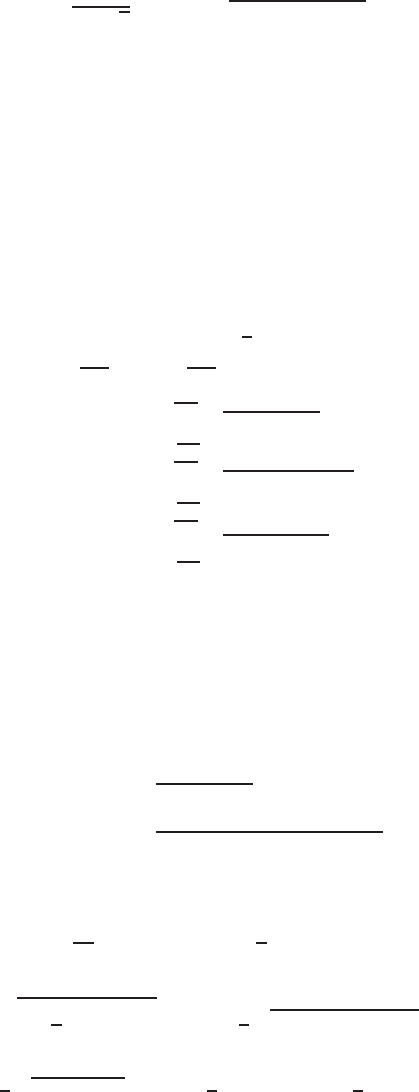
8.2 SOLUTIONS 741
Thus,
Z4
1p1 + √x dx =Z4
1q1 + (0.8x5/4)′2dx,
which is the arc length of the curve y= 0.8x5/4from x= 1 to x= 4. Other possible solutions are any of the curves
y=±0.8x5/4+C.
65. The graph of fis concave down where f′′ <0:
f(x) = e−x2.
f′(x)=−2xe−x2
f′′(x) = −2e−x2+ 4x2e−x2
= 2e−x22x2−1.
This means that f′′(x)<0where
2x2−1<0
x2<1
2.
Thus, the graph is concave down for −p1/2< x < p1/2. The arc length of this portion of the graph of fis given by
Arc length =Z√1/2
−√1/2q1 + (f′(x))2dx
=Z√1/2
−√1/2q1 + −2xe−x22dx
=Z√1/2
−√1/2p1 + 4x2e−2x2dx.
66. The graph of fis concave down where f′′(x)<0:
f(x) = x4−8x3+ 18x2+ 3x+ 7
f′(x) = 4x3−24x2+ 36x+ 3
f′′(x) = 12x2−48x+ 36
= 12(x−1)(x−3).
Hence f′′(x)<0for 1< x < 3. The arc length of this portion of the graph of fis given by
Arc length =Z3
1q1 + (f′(x))2dx
=Z3
1q1 + (4x3−24x2+ 36x+ 3)2dx.
67. The arc length of the catenary between x=−band x=bis 10 meters. Since
d
dx (cosh x) = sinh x=1
2(ex−e−x),
we have
Arc length =Zb
−br1 + 1
4(ex−e−x)2dx =Zb
−b
1
2p4 + e2x−2 + e−2xdx
=Zb
−b
1
2p(ex+e−x)2dx =Zb
−b
1
2(ex+e−x)dx =1
2(ex−e−x)
b
−b
=eb−e−b.
Thus
eb−e−b= 10.
Solving numerically gives b= 2.312 meters. Thus, the ends of the chain are 2(2.312) = 4.624 meters apart.

742 Chapter Eight /SOLUTIONS
68. Here are many functions which “work.”
•Any linear function y=mx +b“works.” This follows because dy
dx =mis constant for such functions. So
Zb
ar1 + dy
dx 2
dx =Zb
ap1 + m2dx = (b−a)p1 + m2.
•The function y=x4
8+1
4x2“works”: dy
dx =1
2(x3−1/x3), and
Zr1 + dy
dx 2
dx=Zs1 + x3−1
x3
4
2
dx =Zr1 + x6
4−1
2+1
4x6dx
=Zr1
4x3+1
x32
dx =Z1
2x3+1
x3dx
=x4
8−1
4x2+C.
•One more function that “works” is y= ln(cos x); we have dy
dx =−sin x/ cos x. Hence
Zr1 + dy
dx 2
dx. =Zr1 + −sin x
cos x2
dx =Zr1 + sin2x
cos2xdx
=Zrsin2x+ cos2x
cos2xdx =Zr1
cos2xdx
=Z1
cos xdx =1
2ln
sin x+ 1
sin x−1+C,
where the last integral comes from IV-22 of the integral tables.
69. (a) If f(x) = Rx
0pg′(t)2−1dt, then, by the Fundamental Theorem of Calculus, f′(x) = pg′(x)2−1. So the arc
length of ffrom 0to xis
Zx
0p1 + (f′(t))2dt =Zx
0q1 + (pg′(t)2−1)2dt
=Zx
0p1 + g′(t)2−1dt
=Zx
0
g′(t)dt=g(x)−g(0) = g(x).
(b) If gis the arc length of any function f, then by the Fundamental Theorem of Calculus, g′(x) = p1 + f′(x)2≥1.
So if g′(x)<1,gcannot be the arc length of a function.
(c) We find a function fwhose arc length from 0to xis g(x) = 2x. Using part (a), we see that
f(x) = Zx
0p(g′(t))2−1dt =Zx
0p22−1dt =√3x.
This is the equation of a line. Does it make sense to you that the arc length of a line segment depends linearly on its
right endpoint?
70. (a) For n= 1, we have
|x|+|y|= 1.
In the first quadrant, the equation is the line
x+y= 1.
By symmetry, the graph in the other quadrants gives the square in Figure 8.42.
For n= 2, the equation is of a circle of radius 1, centered at the origin:
x2+y2= 1.
For n= 4, the equation is
x4+y4= 1.
The graph is similar to a circle, but bulging out more. See Figure 8.42.
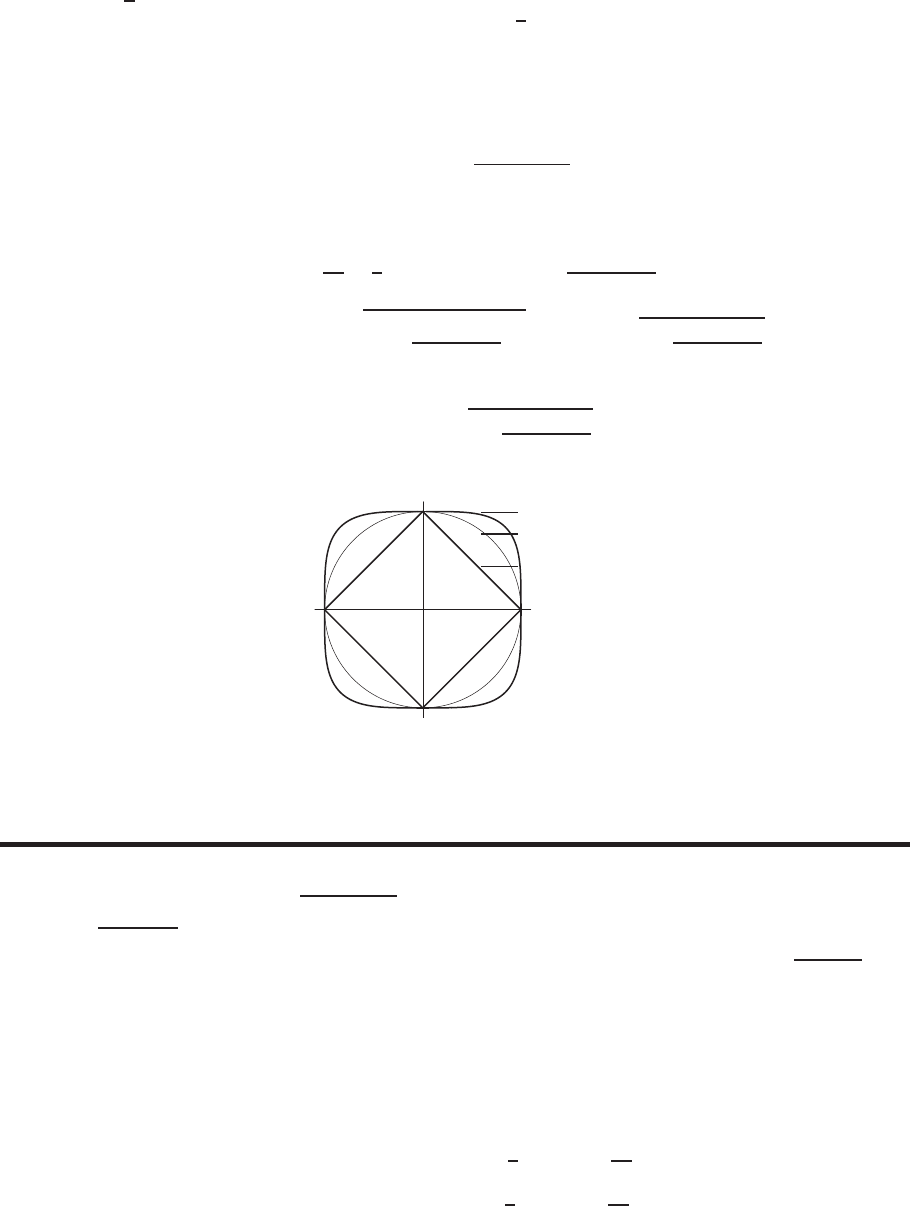
8.2 SOLUTIONS 743
(b) For n= 1, the arc length is the perimeter of the square. Each side is the hypotenuse of a right triangle of sides
1,1,√2. Thus
Arc length = 4√2 = 5.657.
For n= 2, the arc length is the perimeter of the circle of radius 1. Thus
Arc length = 2π·1 = 2π= 6.283.
For n= 4, we find the arc length using the formula
L=Zb
ap1 + (f′(x))2dx.
We find the arc length of the top half of the curve, given by y= (1 −x4)1/4, and double it. Since
dy
dx =1
4(1 −x4)−3/4(−4x3) = −x3
(1 −x4)3/4,
Arc length = 2 Z1
−1s1 + −x3
(1 −x4)3/42
dx = 2 Z1
−1r1 + x6
(1 −x4)3/2dx.
The integral is improper because the integral is not defined at x=±1. Using numerical methods, we find
Arc length = 2 Z1
−1r1 + x6
(1 −x4)3/2dx = 7.018.
−1 1
−1
1
✛|x|+|y|= 1
✛x2+y2= 1
✛x4+y4= 1
x
y
Figure 8.42
Strengthen Your Understanding
71. The volume is R5
0π(3x)2−π(2x)2dx, since the slices are disks-with-holes.
72. The arc length is given by Rπ/4
0p1 + (f′(x))2dx with f(x) = sin x. Thus, the correct formula for the arc length is
Rπ/4
0√1 + cos2x dx.
73. The curve begins at the point (0,0) and ends at the point (2,32).The distance between these points is √22+ 322>32.
Since the arc length of any curve is greater than or equal to the length of the straight line connecting the points, the arc
length of y=x5between x= 0 and x= 2 must be greater than 32.
74. The triangular region with vertices (0,0),(0,1) and (1,0) gives the exact same solid shape whether rotated about the x-
or y-axis.
75. One example is the region bounded by y= 2xand the x-axis for 0≤x≤1. When the region is rotated about the x-axis,
we get a cone of radius 2and height 1. When it is rotated about the y-axis, we get a cone of radius 1 and height 2.
Since
Volume around x-axis =1
3π·22·1 = 4π
3
Volume around y-axis =1
3π·12·2 = 2π
3,
the volume is greater around the x-axis than around the y-axis.
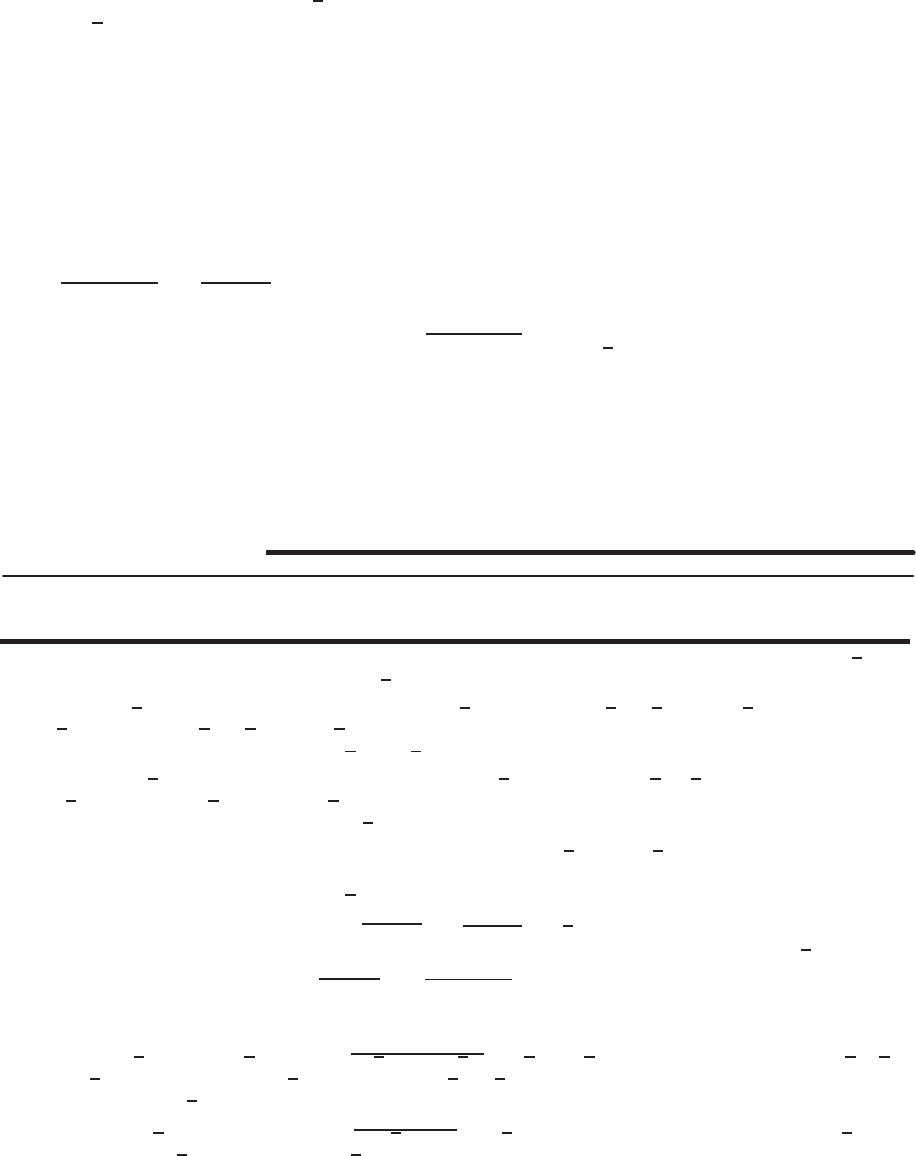
744 Chapter Eight /SOLUTIONS
76. The circle of radius 5 centered at (5,0) goes through both the points (0,0) and (10,0). The upper semicircle and the lower
semicircle are different curves between these two points that have the same arc length, namely half the circumference of
the circle.
77. The distance from (0,0) to (1,1) is √2,so any curve other than a straight line between the points has an arc length greater
than √2. One possible example is f(x) = x2.
78. False. The volume also depends on how far away the region is from the axis of revolution. For example, let Rbe the
rectangle 0≤x≤8,0≤y≤1and let Sbe the rectangle 0≤x≤3,0≤y≤2. Then rectangle Rhas area greater
than rectangle S. However, when you revolve Rabout the x-axis you get a cylinder, lying on its side, of radius 1and
length 8, which has volume 8π. When you revolve Sabout the x-axis, you get a cylinder of radius 2and length 3, which
has volume 12π. Thus the second volume is larger, even though the region revolved has smaller area.
79. False. Suppose that the graph of fstarts at the point (0,100) and then goes down to (1,0) and from there on goes along
the x-axis. For example, if f(x) = 100(x−1)2on the interval [0,1] and f(x) = 0 on the interval [1,10], then fis
differentiable on the interval [0,10]. The arc length of the graph of fon the interval [0,1] is at least 100, while the arc
length on the interval [1,10] is 9.
80. True. Since fis concave up, f′is an increasing function, so f′(x)≥f′(0) = 3/4on the interval [0,4]. Thus
p1 + (f′(x))2≥p1 + 9/16 = 5/4. Then we have:
Arc length =Z4
0p1 + (f′(x))2dx ≥Z4
0
5
4dx = 5.
81. False. Since fis concave down, this means that f′(x)is decreasing, so f′(x)≤f′(0) = 3/4on the interval [0,4].
However, it could be that f′(x)becomes negative so that (f′(x))2becomes large, making the integral for the arc length
large also. For example, f(x) = (3/4)x−x2is concave down and f′(0) = 3/4, but f(0) = 0 and f(4) = −13, so the
graph of fon the interval [0,4] has arc length at least 13.
Solutions for Section 8.3
Exercises
1. With r= 1 and θ= 2π/3, we find x=rcos θ= 1 ·cos(2π/3) = −1/2and y=rsin θ= 1 ·sin(2π/3) = √3/2.
The rectangular coordinates are (−1/2,√3/2).
2. With r=√3and θ=−3π/4, we find x=rcos θ=√3 cos(−3π/4) = √3(−√2/2) = −√6/2and y=rsin θ=
√3 sin(−3π/4) = √3(−√2/2) = −√6/2.
The rectangular coordinates are (−√6/2,−√6/2).
3. With r= 2√3and θ=−π/6, we find x=rcos θ= 2√3 cos(−π/6) = 2√3·√3/2 = 3 and y=rsin θ=
2√3 sin(−π/6) = 2√3(−1/2) = −√3.
The rectangular coordinates are (3,−√3).
4. With r= 2 and θ= 5π/6, we find x=rcos θ= 2 cos(5π/6) = 2(−√3/2) = −√3and y=rsin θ= 2 sin(5π/6) =
2(1/2) = 1.
The rectangular coordinates are (−√3,1).
5. With x= 1 and y= 1, find rfrom r=px2+y2=√12+ 12=√2. Find θfrom tan θ=y/x = 1/1 = 1. Thus,
θ= tan−1(1) = π/4. Since (1,1) is in the first quadrant this is a correct θ. The polar coordinates are (√2, π/4).
6. With x=−1and y= 0, find r=px2+y2=p(−1)2+ 02= 1. Find θfrom tan θ=y/x = 0/(−1) = 0. Thus,
θ= tan−1(0) = 0. Since (−1,0) is on the x-axis between the second and third quadrant, θ=π. The polar coordinates
are (1, π).
7. With x=√6and y=−√2, find r=p(√6)2+ (−√2)2=√8 = 2√2. Find θfrom tan θ=y/x =−√2/√6 =
−1/√3. Thus, θ= tan−1(−1/√3) = −π/6. Since (√6,−√2) is in the fourth quadrant, this is the correct θ. The polar
coordinates are (2√2,−π/6).
8. With x=−√3and y= 1, find r=p(−√3)2+ 12=√4 = 2. Find θfrom tan θ=y/x = 1/(−√3). Thus,
θ= tan−1(−1/√3) = −π/6. Since (−√3,1) is in the second quadrant, θ=−π/6+ π= 5π/6. The polar coordinates
are (2,5π/6).
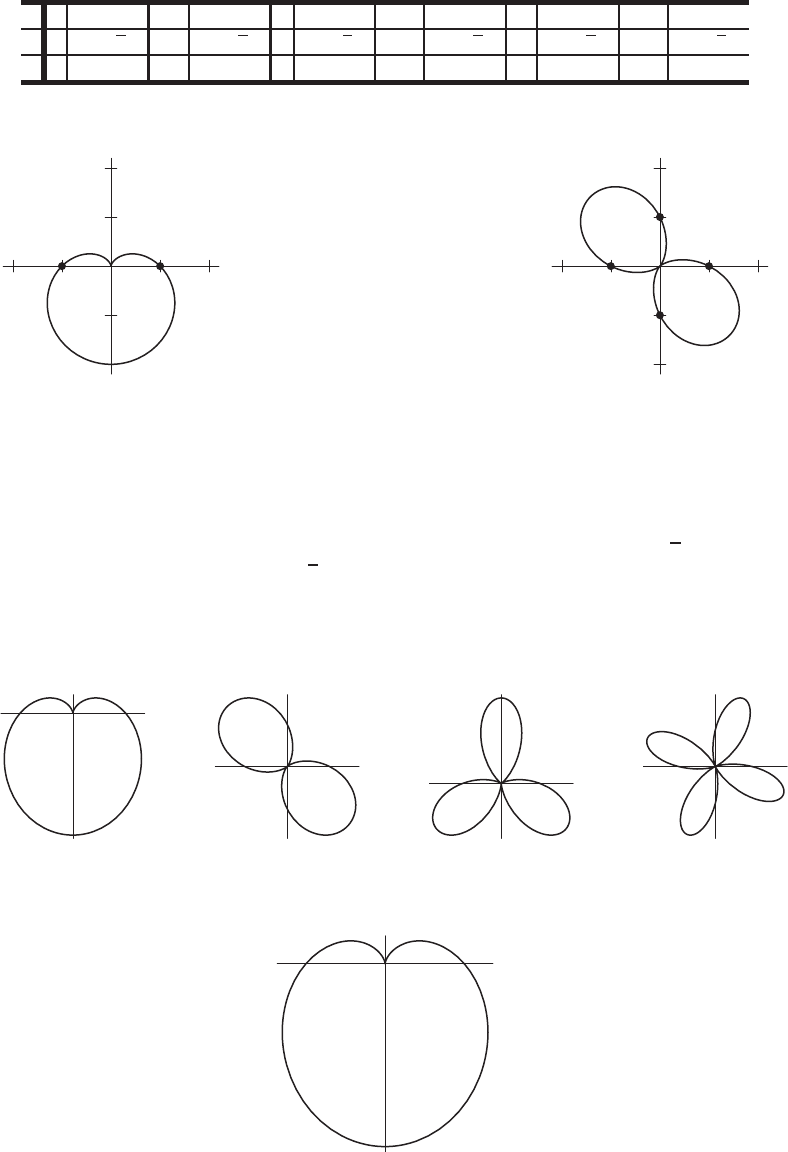
8.3 SOLUTIONS 745
9. (a) Table 8.5 contains values of r= 1 −sin θ, both exact and rounded to one decimal.
Table 8.5
θ0π/3π/2 2π/3π4π/3 3π/2 5π/3 2π7π/3 5π/2 8π/3
r1 1 −√3/2 0 1 −√3/2 1 1 + √3/2 2 1 + √3/2 1 1 −√3/2 0 1 −√3/2
r10.134 00.134 11.866 2 1.866 1 0.134 00.134
(b) See Figure 8.43.
−2−1 1 2
−2
−1
1
2
x
y
Figure 8.43
−2−1 1 2
−2
−1
1
2
x
y
Figure 8.44
(c) The circle has equation r= 1/2. The cardioid is r= 1 −sin θ. Solving these two simultaneously gives
1/2 = 1 −sin θ,
or
sin θ= 1/2.
Thus, θ=π/6or 5π/6. This gives the points (x, y) = ((1/2) cos π/6,(1/2) sin π/6) = (√3/4,1/4) and (x, y) =
((1/2) cos 5π/6,(1/2) sin 5π/6) = (−√3/4,1/4) as the location of intersection.
(d) The curve r= 1 −sin 2θ, pictured in Figure 8.44, has two regions instead of the one region that r= 1 −sin θhas.
This is because 1−sin 2θwill be 0 twice for every 2πcycle in θ, as opposed to once for every 2πcycle in θfor
1−sin θ.
10. There will be nloops. See Figures 8.45-8.48.
Figure 8.45
:n= 1
Figure 8.46
:n= 2
Figure 8.47
:n= 3
Figure 8.48
:n= 4
11. The graph will begin to draw over itself for any θ≥2πso the graph will look the same in all three cases. See Figure 8.49.
Figure 8.49
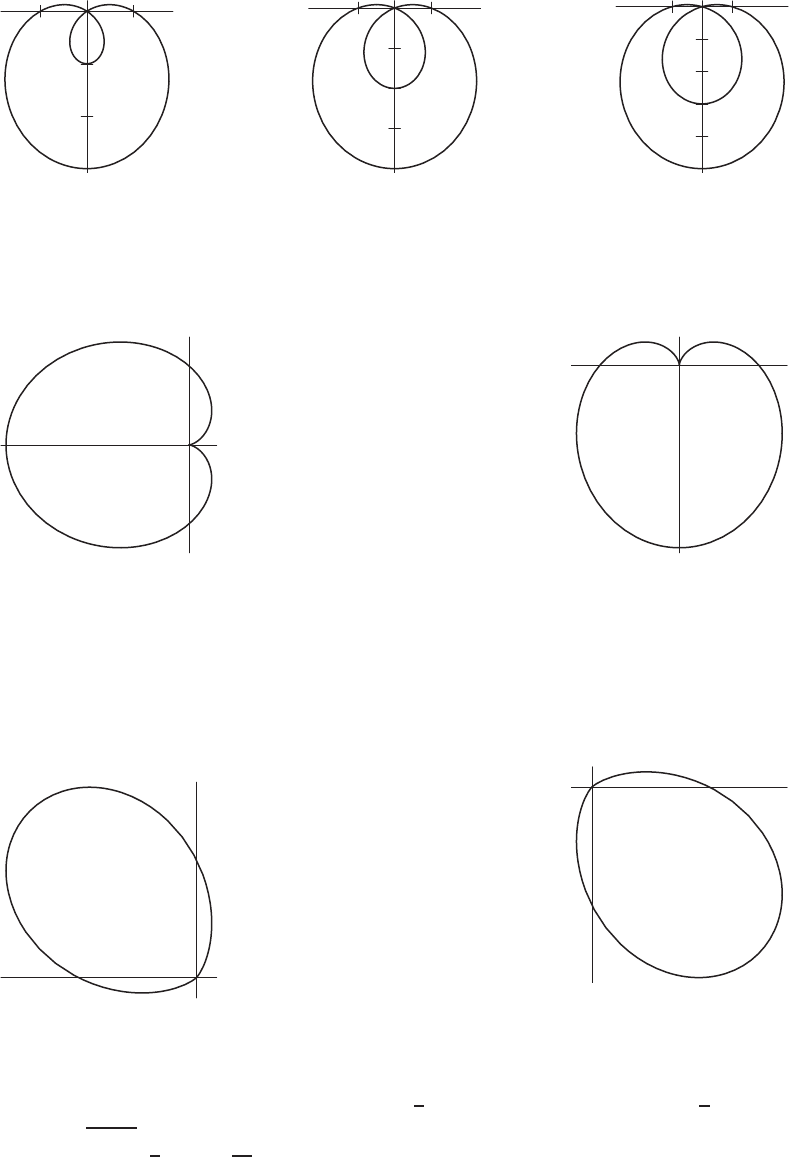
746 Chapter Eight /SOLUTIONS
12. The curve will be a smaller loop inside a larger loop with an intersection point at the origin. Larger nvalues increase the
size of the loops. See Figures 8.50-8.52.
−11
−3
−2
−1
Figure 8.50
:n= 2
−11
−4
−3
−2
−1
Figure 8.51
:n= 3
−11
−5
−4
−3
−2
−1
Figure 8.52
:n= 4
13. See Figures 8.53 and 8.54. The first curve will be similar to the second curve, except the cardioid (heart) will be rotated
clockwise by 90◦(π/2radians). This makes sense because of the identity sin θ= cos(θ−π/2).
Figure 8.53
:r= 1 −cos θ
Figure 8.54
:r= 1 −sin θ
14. Let 0≤θ≤2πand 3/16 ≤r≤1/2.
15. A loop starts and ends at the origin, that is, when r= 0. This happens first when θ=π/4and next when θ= 5π/4. This
can also be seen by using a trace mode on a calculator. Thus restricting θso that π/4≤θ≤5π/4will graph the upper
loop only. See Figure 8.55. To show only the other loop use 0≤θ≤π/4and 5π/4≤θ≤2π. See Figure 8.56.
Figure 8.55
:π/4≤θ≤5π/4
Figure 8.56
:0≤θ≤π/4and
5π/4≤θ≤2π
16. (a) Let 0≤θ≤π/4and 0≤r≤1.
(b) Break the region into two pieces: one with 0≤x≤√2/2and 0≤y≤x, the other with √2/2≤x≤1and
0≤y≤√1−x2.
17. The region is given by √8≤r≤√18 and π/4≤θ≤π/2.
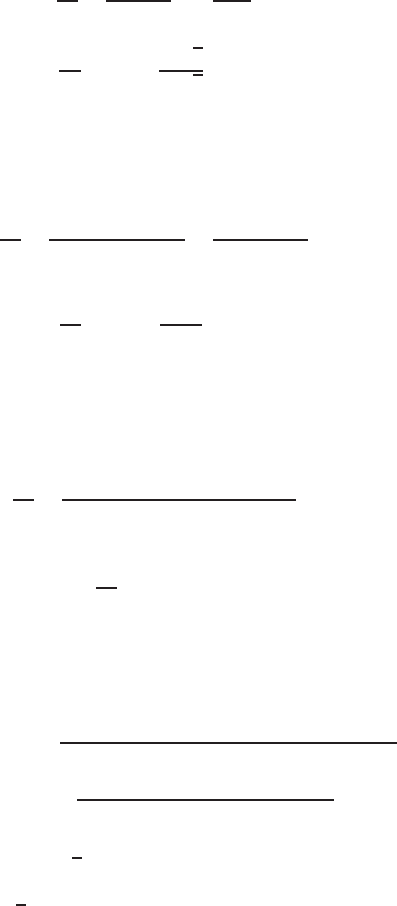
8.3 SOLUTIONS 747
18. The region is given by 0≤r≤2and −π/6≤θ≤π/6.
19. The circular arc has equation r= 1, for 0≤θ≤π/2. the vertical line x= 2 has polar equation rcos θ= 2, or
r= 2/cos θ. So the region is described by 0≤θ≤π/2and 1≤r≤2/cos θ.
20. Expressing xand yin terms of θ, we have
x= 2 cos θand y= 2 sin θ.
The slope is given by
dy
dx =−2 cos θ
2 sin θ=−cos θ
sin θ.
At θ=π/4, we have
dy
dx θ=π/4
=1/√2
1/√2=−1.
21. Expressing xand yin terms of θ, we have
x=eθcos θand y=eθsin θ.
The slope is given by
dy
dx =eθsin θ+eθcos θ
eθcos θ−eθsin θ=sin θ+ cos θ
cos θ−sin θ.
At θ=π/2, we have sin θ= 1 and cos θ= 0, so
dy
dx θ=π/2
=1 + 0
0−1=−1.
22. Expressing xand yin terms of θ, we have
x= (1 −cos θ) cos θand y= (1 −cos θ) sin θ.
The slope is given by
dy
dx =−(1 −cos θ) cos θ−sin θsin θ
(1 −cos θ) sin θ−sin θcos θ.
At θ=π/2, we have cos θ= 0 and sin θ= 1, so that
dy
dx θ=π/2
=−1.
23. The curve is given parametrically by
x=eθcos θand y=eθsin θ.
Thus, calculating dx/dθ and dy/dθ, gives
Arc length =Zπ
π/2p(eθcos θ−eθsin θ)2+ (eθsin θ+eθcos θ)2dθ
=Zπ
π/2
eθp(cos θ−sin θ)2+ (sin θ+ cos θ)2dθ
=Zπ
π/2
eθ√2dθ
=√2(eπ−eπ/2).
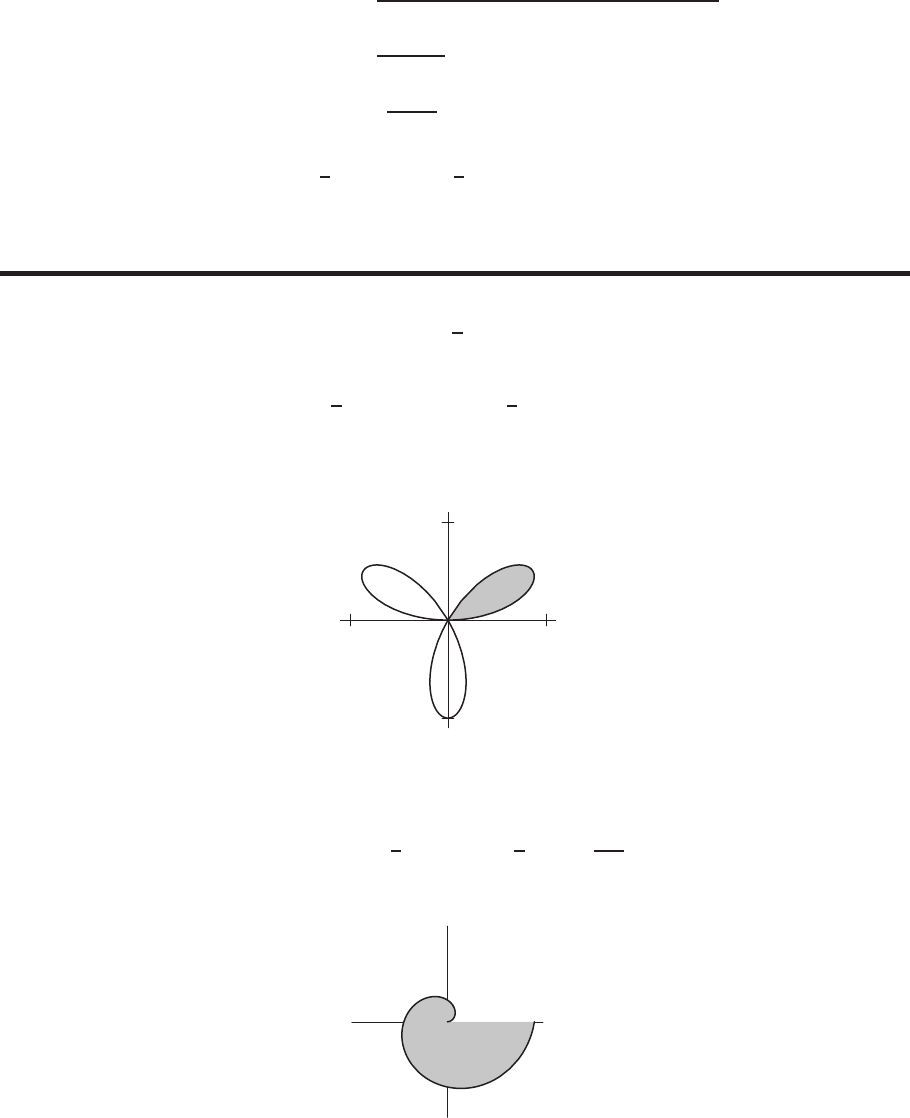
748 Chapter Eight /SOLUTIONS
24. The curve is given parametrically by
x=θ2cos θand y=θ2sin θ.
Thus, calculating dx/dθ and dy/dθ, gives
Arc length =Z2π
0p(2θcos θ−θ2sin θ)2+ (2θsin θ+θ2cos θ)2dθ
=Z2π
0p4θ2+θ4dθ
=Z2π
0
θp4 + θ2dθ
=1
3(4 + 4π2)3/2−1
343/2.
Problems
25. The formula for area is
A=1
2Zβ
α
r2dθ
Therefore, since
A=1
2Zπ/3
0
sin2(3θ)dθ =1
2Zπ/3
0
(sin 3θ)2dθ,
we have r= sin 3θ. The integral represents the shaded area inside one petal of the three-petaled rose curve, r= sin 3θ,
in Figure 8.57.
−1 1
−1
1
x
y
Figure 8.57
: Graph of r= sin 3θ
26. The spiral is shown in Figure 8.58.
Area =1
2Z2π
0
θ2dθ =1
6θ3
2π
0
=8π3
6.
−π2π
π/2
x
y
Figure 8.58
: Spiral r=θ
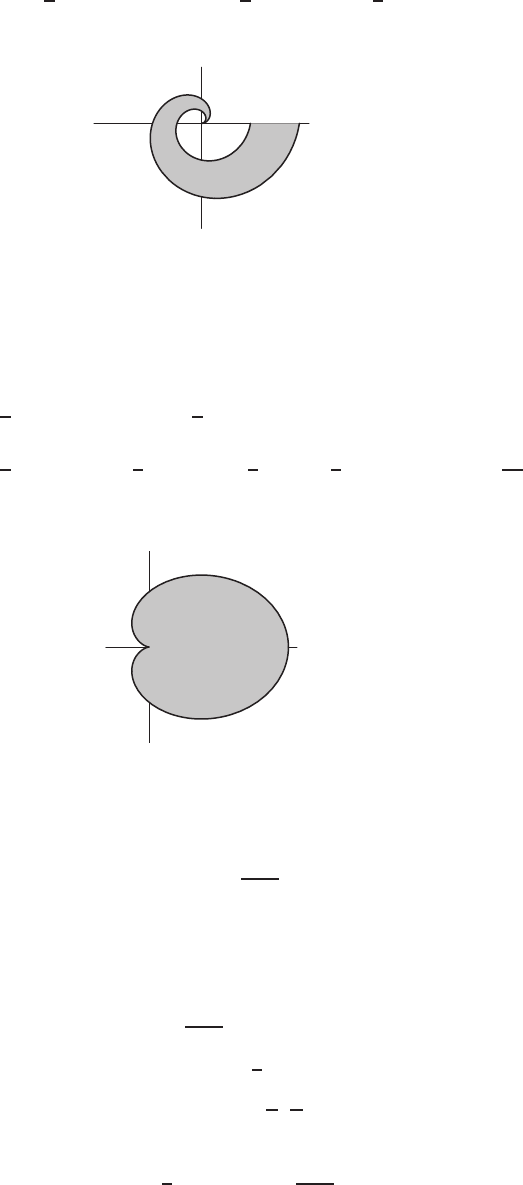
8.3 SOLUTIONS 749
27. The region between the spirals is shaded in Figure 8.59.
Area =1
2Z2π
0
((2θ)2−θ2)dθ =1
2Z2π
0
3θ2dθ=1
2θ3
2π
0
=4π3.
2π4πx
y
Figure 8.59
: Region between the
inner spiral, r=θ, and the outer
spiral, r= 2θ
28. The cardioid is shown in Figure 8.60. The following integral can be evaluated using a calculator or by parts or using the
table of integrals.
Area =1
2Z2π
0
(1 + cos θ)2dθ =1
2Z2π
01 + 2 cos θ+ cos2θdθ
=1
2θ+ 2 sin θ+1
2cos θsin θ+1
2θ
2π
0
=1
2(2π+ 0 + 0 + π) = 3π
2.
x
y
Figure 8.60
: Cardioid
r= 1 + cos θ
29. (a) See Figure 8.61. In polar coordinates, the line x= 1 is rcos θ= 1, so its equation is
r=1
cos θ.
The circle of radius 2centered at the origin has equation
r= 2.
(b) The line and circle intersect where
1
cos θ= 2
cos θ=1
2
θ=−π
3,π
3.
Thus,
Area =1
2Zπ/3
−π/322−1
cos θ2dθ.
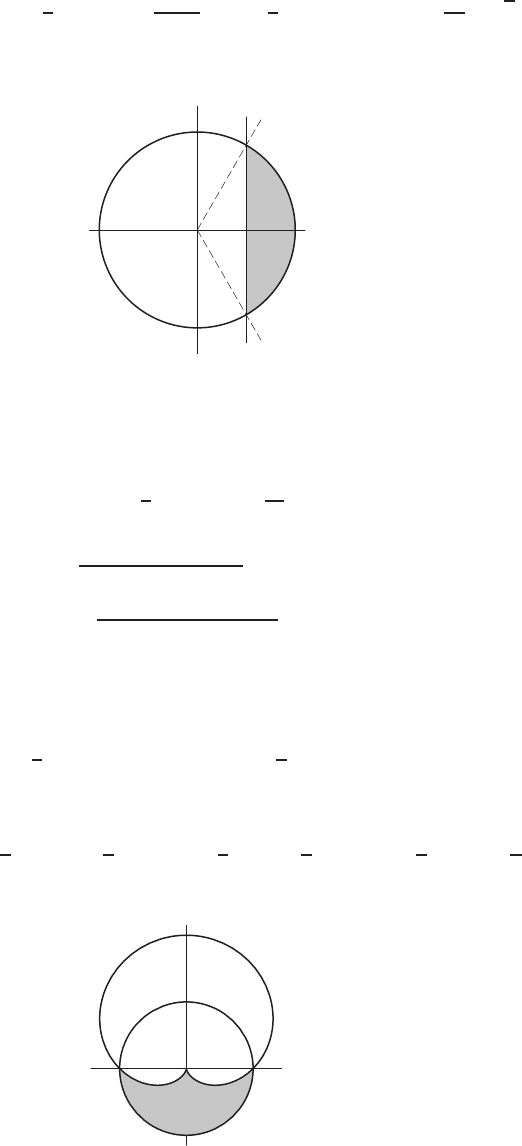
750 Chapter Eight /SOLUTIONS
(c) Evaluating gives
Area =1
2Zπ/3
−π/34−1
cos2θdθ =1
2(4θ−tan θ)
π/3
−π/3
=4π
3−√3.
1 2
x= 1
θ=π/3
θ=−π/3
x
y
Figure 8.61
30. Using the formula Area= (1/2) Rβ
α(f(θ))2dθ gives
Area = 1
2Z2π
0
a2dθ =a2
2θ
2π
0
=πa2,
which is the formula for the area of a disk of radius a.
31. Using the formula Arc length =Rβ
αp(dx/dθ)2+ (dy/dθ)2dθ, where x=acos θ,y=asin θand a > 0gives
Arc length = Z2π
0p(−asin θ)2+ (acos θ)2dθ =Z2π
0
a dθ =aθ|2π
0= 2πa,
which is the formula for the circumference of a circle of radius a.
32. See Figure 8.62. Notice that the curves intersect at (1,0), where θ= 0,2π, and at (−1,0), where θ=π, so
Area =1
2Z2π
π
(12−(1 + sin θ)2)dθ =1
2Z2π
π
(−2 sin θ−sin2θ)dθ.
Using a calculator, integration by parts, or formula IV-17 in the integral table, we have
Area =1
22 cos θ+1
2sin θcos θ−1
2θ
2π
π
=1
22·2 + 0 −1
2π= 2 −π
4.
1−1
r= 1
r= 1 + sin θ
x
y
Figure 8.62

8.3 SOLUTIONS 751
33. The two curves intersect where
1−sin θ=1
2
sin θ=1
2
θ=π
6,5π
6.
See Figure 8.63. We find the area of the right half and multiply that answer by 2to get the entire area. The integrals can be
computed numerically with a calculator or, as we show, using integration by parts or formula IV-17 in the integral tables.
Area of right half =1
2Zπ/6
−π/2(1 −sin θ)2−1
22dθ
=1
2Zπ/6
−π/21−2 sin θ+ sin2θ−1
4dθ
=1
2Zπ/6
−π/23
4−2 sin θ+ sin2θdθ
=1
23
4θ+ 2 cos θ−1
2sin θcos θ+1
2θ
π/6
−π/2
=1
25π
6+7√3
8.
Thus,
Total area =5π
6+7√3
8.
1
2
1
2r= 1 −sin θ
r= 1/2π/6
x
y
Figure 8.63
34. Figure 8.64 shows the curves which touch at (2,0) and the origin. However, the circle lies entirely inside the cardioid, so
we find the area by subtracting the area of the circle from that of the cardioid. To find the areas, we take the integrals.
The cardioid, r= 1 + cos θ, starts at (2,0) when θ= 0 and traces the top half, reaching the origin when θ=π.
Thus
Area of cardioid = 2 ·1
2Zπ
0
(1 + cos θ)2dθ.
The circle starts at (2,0) when θ= 0 and traces the top half, reaching the origin when θ=π/2. Thus
Area of circle = 2 ·1
2Zπ/2
0
(2 cos θ)2dθ.
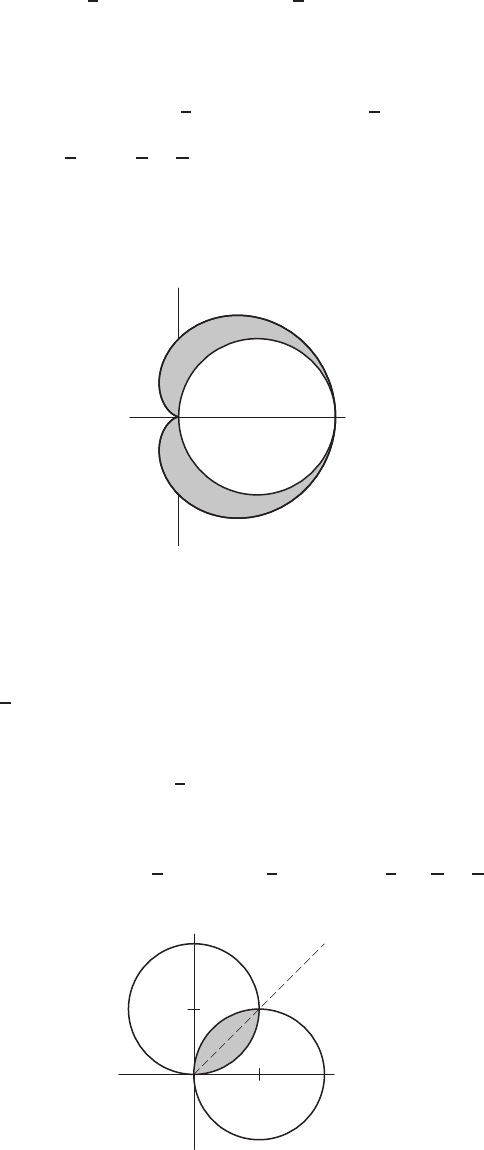
752 Chapter Eight /SOLUTIONS
The area, A, we want is therefore
Area = 2 ·1
2Zπ
0
(1 + cos θ)2dθ −2·1
2Zπ/2
0
(2 cos θ)2dθ
=Zπ
0
(1 + 2 cos θ+ cos2θ)dθ −Zπ/2
0
4 cos2θ dθ
=θ+ 2 sin θ+1
2(sin θcos θ+θ)
π
0−4
2(sin θcos θ+θ)
π/2
0
=3
2π−2·π
2=π
2.
Alternatively, we could compute the area of the cardioid and subtract the area of the circle of radius 1from it.
The integrals can be computed numerically using a calculator, or, as we show, using integration by parts or for-
mula IV-18 from the integral tables.
r= 1 + cos θ
r= 2 cos θ
x
y
Figure 8.64
35. (a) The graph of r= 2 cos θis a circle of radius 1centered at (1,0); the graph of r= 2 sin θis a circle of radius 1
centered at (0,1). See Figure 8.65.
(b) The Cartesian coordinates of the points of intersection are at (0,0) and (1,1).
The origin corresponds to θ=π/2on r= 2 cos θand to θ= 0 on r= 2 sin θ. The point (1,1) has polar
coordinates r=√2, θ =π/4.
We find the area below the line θ=π/4and above r= 2 sin θand double it:
Area = 2 ·1
2Zπ/4
0
(2 sin θ)2dθ = 4 Zπ/4
0
sin2θ dθ.
Using a calculator, integration by parts or formula IV-17 from the integral tables,
Area = 4 −1
2sin θcos θ+θ
2
π/4
0
=−2·1
2+ 2 π
4=π
2−1.
12
1
2r= 2 sin θ
r= 2 cos θ
θ=π/4
x
y
Figure 8.65

8.3 SOLUTIONS 753
36. The area is
A=1
2Za
0
r2dθ =1
2Za
0
θ2dθ = 1
1
2θ3
3
a
0
= 1
a3
6= 1
a3= 6
a=3
√6.
37. (a) See Figure 8.66.
(b) The curves intersect when r2= 2
4 cos 2θ= 2
cos 2θ=1
2.
In the first quadrant:
2θ=π
3so θ=π
6.
Using symmetry, the area in the first quadrant can be multiplied by 4to find the area of the total bounded region.
Area = 4 1
2Zπ/6
0
(4 cos 2θ−2) dθ
= 2 4 sin 2θ
2−2θ
π/6
0
= 4 sin π
3−2
3π
= 4 √3
2−2
3π
= 2√3−2
3π= 1.370.
−2 2
−1.5
1.5
r=√2
r2= 4 cos 2θ
x
y
Figure 8.66
38. The slope of the tangent line at θ=π/3is dy/dx =√3/5. Since x= 3 sin(2θ) cos θand y= 3 sin(2θ) sin θ, when
θ=π/3, we have x= 3√3/4and y= 9/4. Thus, the equation of the tangent line is
y−9
4=√3
5x−3√3
4
y=√3
5x−9
20 +9
4
y=√3
5x+9
5.

754 Chapter Eight /SOLUTIONS
39. We first find the points with horizontal and vertical tangents in the first quadrant and then use symmetry to obtain the
points in other quadrants.
The slope of the tangent line is
dy
dx =6 cos(2θ) sin θ+ 3 sin(2θ) cos θ
6 cos(2θ) cos θ−3 sin(2θ) sin θ.
The curve has a horizontal tangent where
6 cos(2θ) sin θ+ 3 sin(2θ) cos θ= 0.
Solving this equation numerically for 0< θ < π/2, we have θ= 0.9553; in addition θ= 0 is a solution. Thus, there
are horizontal tangents where x= 1.633 and y= 2.309 and where x= 0,y= 0. Thus, the five points with horizontal
tangents are
(1.633,2.309); (−1.633,2.309); (−1.633,−2.309); (1.633,−2.309); (0,0).
The curve has vertical tangents where
6 cos(2θ) cos θ−3 sin(2θ) sin θ= 0.
Solving this equation numerically for 0< θ < π/2, we have θ= 0.6155; in addition θ=π/2is a solution. Thus, there
are vertical tangents where x= 2.309,y= 1.633, and where x= 0, y = 0. Thus, there are five points with vertical
tangents:
(2.309,1.633); (−2.309,1.633); (−2.309,−1.633); (2.309,−1.633); (0,0).
40. We can express xand yin terms of θas a parameter. Since r=θ, we have
x=rcos θ=θcos θand y=rsin θ=θsin θ.
Calculating the slope using the parametric formula,
dy
dx =dy/dθ
dx/dθ ,
we have dy
dx =sin θ+θcos θ
cos θ−θsin θ.
Horizontal tangents occur where dy/dx = 0, so
sin θ+θcos θ= 0
θ=−tan θ.
Solving this equation numerically gives
θ= 0,2.029,4.913.
Vertical tangents occur where dy/dx is undefined, so
cos θ−θsin θ= 0
θ=1
tan θ= cot θ.
Solving this equation numerically gives
θ= 0.860,3.426.
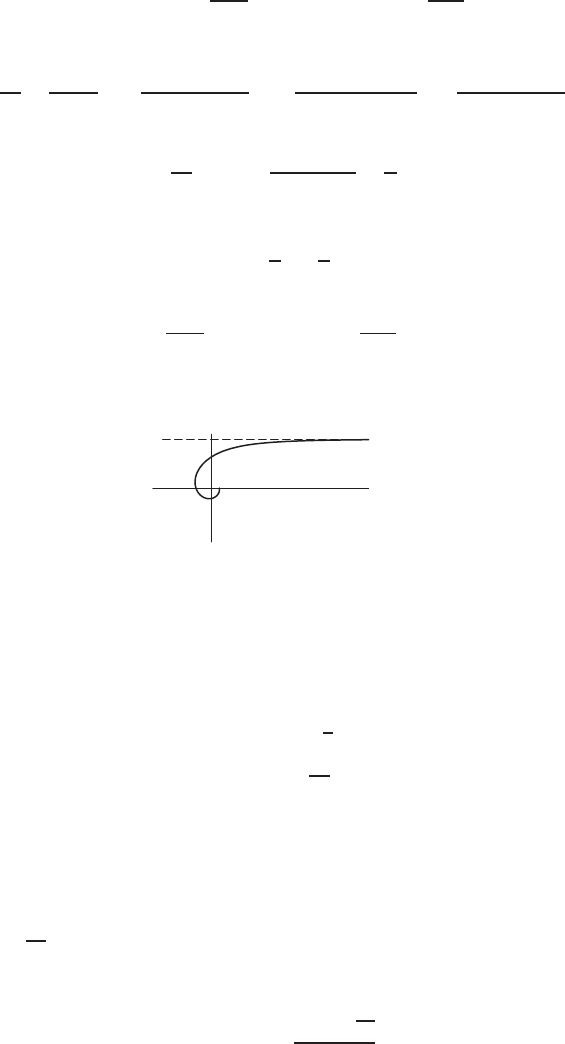
8.3 SOLUTIONS 755
41. (a) Expressing xand yparametrically in terms of θ, we have
x=rcos θ=cos θ
θand y=rsin θ=sin θ
θ.
The slope of the tangent line is given by
dy
dx =dy/dθ
dx/dθ =θcos θ−sin θ
θ2.−θsin θ−cos θ
θ2=sin θ−θcos θ
cos θ+θsin θ.
At θ=π/2, we have
dy
dx θ=π/2
=1−(π/2)0
0 + (π/2)1 =2
π.
At θ=π/2, we have x= 0,y= 2/π, so the equation of the tangent line is
y=2
πx+2
π.
(b) As θ→0,
x=cos θ
θ→ ∞ and y=sin θ
θ→1.
Thus, y= 1 is a horizontal asymptote. See Figure 8.67.
y= 1
r= 1/θ
x
y
Figure 8.67
42. The limac¸on is given by r= 1 + 2 cos θ; see Figure 8.68. At θ= 0, the graph is at (3,0); as θincreases, the graph sweeps
out the top arc (on which the maximum value of yoccurs), reaching the origin when
1 + 2 cos θ= 0
cos θ=−1
2
θ=2π
3.
Thus, we want to find the maximum value of yon the interval 0≤θ≤2π/3. Since y=rsin θ, we want to find the
maximum value of
y= (1 + 2 cos θ) sin θ= sin θ+ 2 cos θsin θ.
At a critical point
dy
dθ = cos θ−2 sin2θ+ 2 cos2θ= 0
cos θ−2(1 −cos2θ) + 2 cos2θ= 0
4 cos2θ+ cos θ−2 = 0
cos θ=−1±√33
8= 0.593,−0.843.
Thus, θ= cos−1(0.593) = 0.936 and θ= cos−1(−0.843) = 2.574 are the critical values. Since 2.574 is outside the
interval 0≤θ≤2π/3, there is one critical point θ= 0.963.
At the endpoints of the interval, y= 0. At θ= 0.936, we have y= 1.760, which is the maximum value.
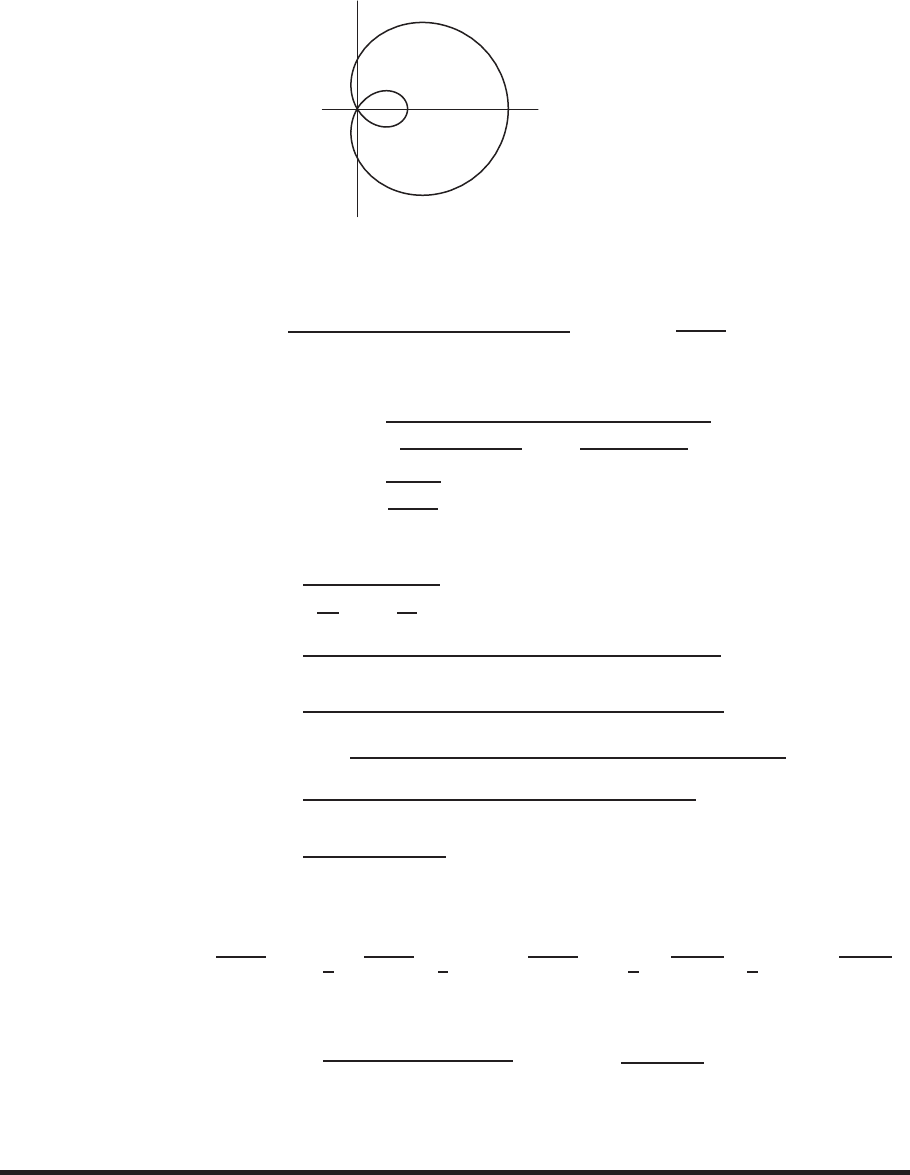
756 Chapter Eight /SOLUTIONS
r= 1 + 2 cos θ
x
y
Figure 8.68
: The inner loop has r < 0
43. Since x=θcos θand y=θsin θ, we have
Arc length =Z2π
0p(cos θ−θsin θ)2+ (sin θ+θcos θ)2dθ =Z2π
0p1 + θ2dθ = 21.256.
44. Since x= cos θ/θ and y= sin θ/θ, we have
Arc length =Z2π
πr−θsin θ−cos θ
θ22
+θcos θ−sin θ
θ22
dθ
=Z2π
πrθ2+ 1
θ4dθ = 0.712.
45. Parameterized by θ, the curve r=f(θ)is given by x=f(θ) cos θand y=f(θ) sin θ. Then
Arc length =Zβ
αrdx
dθ 2
+dy
dθ 2
dθ
=Zβ
αp(f′(θ) cos θ−f(θ) sin θ)2+ (f′(θ) sin θ+f(θ) cos θ)2dθ
=Zβ
αp(f′(θ))2cos2θ−2f′(θ)f(θ) cos θsin θ+ (f(θ))2sin2θ
+(f′(θ))2sin2θ+ 2f′(θ)f(θ) sin θcos θ+ (f(θ))2cos2θ dθ
=Zβ
αp(f′(θ))2(cos2θ+ sin2θ) + (f(θ))2(sin2θ+ cos2θ)dθ
=Zβ
αp(f′(θ))2+ (f(θ))2dθ.
46. Let f(θ) = θ. Then f′(θ) = 1. Using the formula derived in Problem 45, we have
Arclength =Z2π
0p1 + θ2dθ =h1
2θp1 + θ2+1
2ln |θ+p1 + θ2|iπ
0
=1
2πp1 + π2+1
2ln |π+p1 + π2|
47. Let f(θ) = 1 + cos θ. Then f′(θ) = −sin θ. Using numerical methods, we have
Arclength =Zπ/2
0p(−sin θ)2+ (1 + cos θ)2dθ =Zπ/2
0
√2 + 2 cos θ dθ = 2.828.
Strengthen Your Understanding
48. The formula θ= tan−1(y/x)is incorrect if x≤0. If x= 0, then tan−1(y/x)is not defined and so cannot be
used. If x < 0, then the point (x, y)is in quadrant II or III, but tan−1(y/x)is an angle in quadrant I or IV, because
−π/2<tan−1(y/x)< π/2.
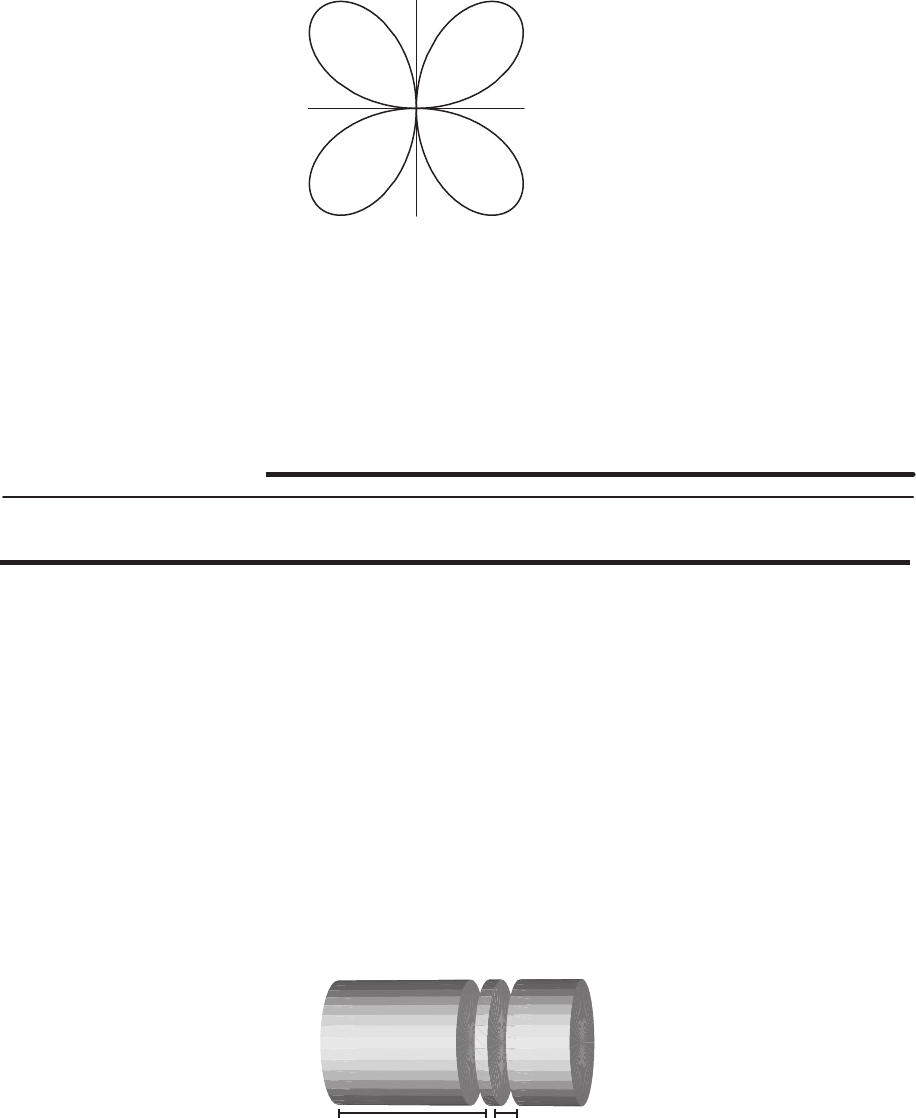
8.4 SOLUTIONS 757
49. The points on the polar curve with π/2< θ < π are in quadrant IV, because r= sin(2θ)<0.
50. Since dr/dθ is the rate of change of rwith respect to θ, it cannot be interpreted as the slope of the polar curve. The circle
r= 1 has positive slope at θ= 3π/4,yet dr/dθ = 0 everywhere, since the radius does not change as θincreases.
51. The rose with four petals, r= 3 sin 2θ, shown in Figure 8.69 is symmetric about both axes.
r= 3 sin 2θ
x
y
Figure 8.69
52. Changing the polar coordinate θby adding 2πdoes not change the point. For example, (r, θ) = (10, π)and (r, θ) =
(10,3π)correspond to the same point (x, y) = (−10,0).
53. The circle of radius kcentered at the origin has equation r=k. For example, r= 100.
54. One example is the Archimedean spiral r=θ.
55. A polar curve is symmetric about the x-axis if replacing θby −θin its formula makes no difference, so any formula
involving only cos θwill work. One such example is the limac¸on r= 1 + cos θ.
Solutions for Section 8.4
Exercises
1. Since density is e−xgm/cm,
Mass =Z10
0
e−xdx =−e−x
10
0
= 1 −e−10 gm.
2. Strips perpendicular to the x-axis have length 3, area 3∆x, and mass 5·3∆xgm. Thus
Mass =Z2
0
5·3dx=Z2
0
15 dx.
Strips perpendicular to the y-axis have length 2, area 2∆y, and mass 5·2∆ygm. Thus
Mass =Z3
0
5·2dy=Z3
0
10 dy.
3. (a) Suppose we choose an x,0≤x≤2. If ∆xis a small fraction of a meter, then the density of the rod is approximately
δ(x)anywhere from xto x+ ∆xmeters from the left end of the rod (see below). The mass of the rod from xto
x+ ∆xmeters is therefore approximately δ(x)∆x= (2 + 6x)∆x. If we slice the rod into Npieces, then a Riemann
sum is
N
X
i=1
(2 + 6xi)∆x.
✛
✛
✛
✛
x∆x2
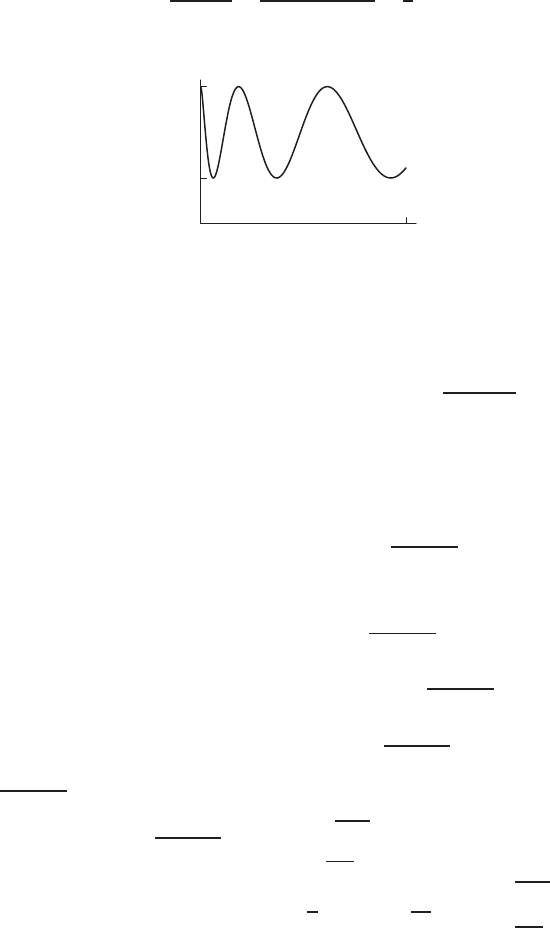
758 Chapter Eight /SOLUTIONS
(b) The definite integral is
M=Z2
0
δ(x)dx =Z2
0
(2 + 6x)dx = (2x+ 3x2)
2
0
= 16 grams.
4. We have
Moment =Z2
0
xδ(x)dx =Z2
0
x(2 + 6x)dx
=Z2
0
(6x2+ 2x)dx = (2x3+x2)
2
0
= 20 gram-meters.
Now, using this and Problem 3 (b), we have
Center of mass =Moment
Mass =20 gram-meters
16 grams =5
4meters (from its left end).
5. (a) Figure 8.70 shows a graph of the density function.
20
300
900
x
Figure 8.70
(b) Suppose we choose an x,0≤x≤20. We approximate the density of the number of the cars between xand x+ ∆x
miles as δ(x)cars per mile. Therefore, the number of cars between xand x+ ∆xis approximately δ(x)∆x. If we
slice the 20 mile strip into Nslices, we get that the total number of cars is
C≈
N
X
i=1
δ(xi)∆x=
N
X
i=1 600 + 300 sin(4√xi+ 0.15)∆x,
where ∆x= 20/N. (This is a right-hand approximation; the corresponding left-hand approximation is
N−1
X
i=0
δ(xi)∆x.)
(c) As N→ ∞,the Riemann sum above approaches the integral
C=Z20
0
(600 + 300 sin 4√x+ 0.15) dx.
If we calculate the integral numerically, we find C≈11513. We can also find the integral exactly as follows:
C=Z20
0
(600 + 300 sin 4√x+ 0.15) dx
=Z20
0
600 dx +Z20
0
300 sin 4√x+ 0.15 dx
= 12000 + 300 Z20
0
sin 4√x+ 0.15 dx.
Let w=√x+ 0.15,so x=w2−0.15 and dx = 2w dw. Then
Zx=20
x=0
sin 4√x+ 0.15 dx = 2 Zw=√20.15
w=√0.15
wsin 4w dw, (using integral table III-15)
= 2 h−1
4wcos 4w+1
16 sin 4wi
√20.15
√0.15
≈ −1.624.
Using this, we have C≈12000 + 300(−1.624) ≈11513, which matches our numerical approximation.
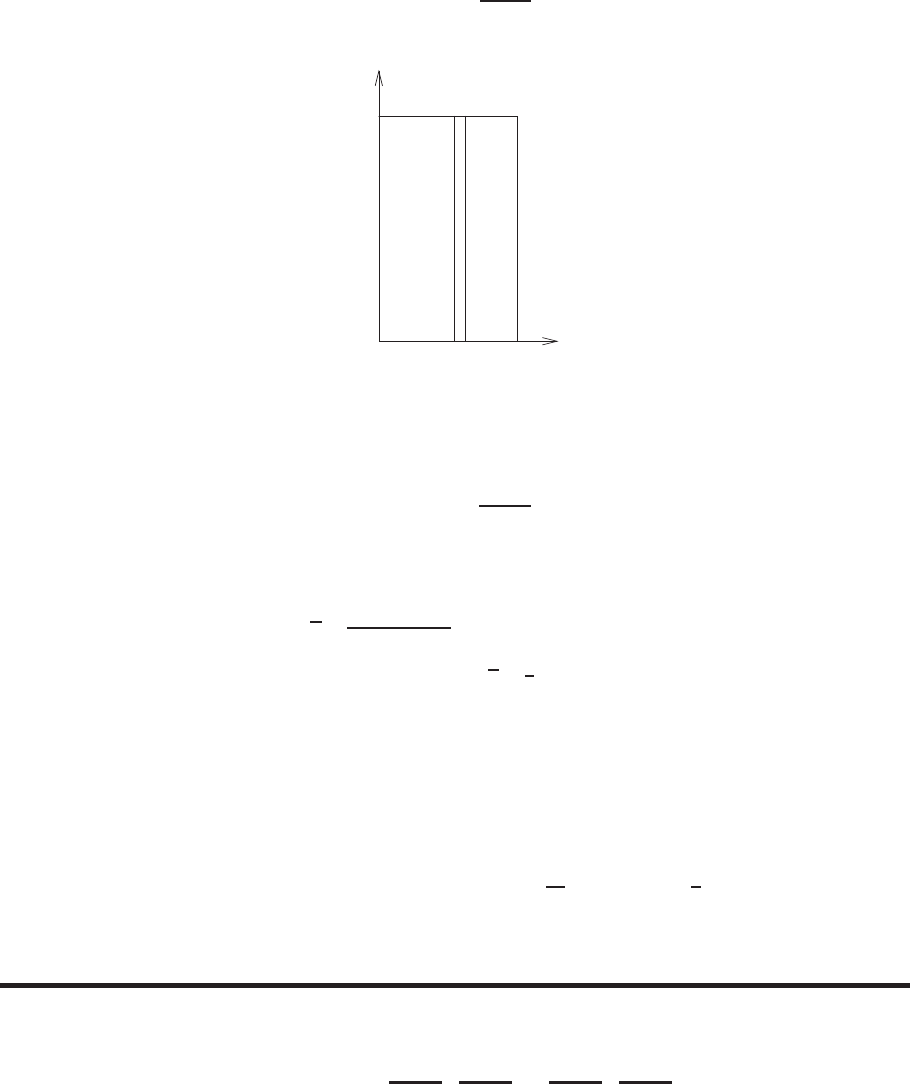
8.4 SOLUTIONS 759
6. (a) Orient the rectangle in the coordinate plane in such a way that the side referred to in the problem—call it S—lies on
the y-axis from y= 0 to y= 5, as shown in Figure 8.71. We may subdivide the rectangle into strips of width ∆x
and length 5. If the left side of a given strip is a distance xaway from S(i.e., the y-axis), its density 2 is 1/(1 + x4).
If ∆xis small enough, the density of the strip is approximately constant—i.e., the density of the whole strip is about
1/(1 + x4). The mass of the strip is just its density times its area, or 5∆x/(1 + x4). Thus the mass of the whole
rectangle is approximated by the Riemann sum
X5∆x
1 + x4,
5
3
y
x
∆x
S
Figure 8.71
(b) The exact mass of the rectangle is obtained by letting ∆x→0in the Riemann sums above, giving us the integral
Z3
0
5dx
1 + x4.
Since it is not easy to find an antiderivative of 5/(1 + x4),we evaluate this integral numerically, getting 5.5.
7. The total mass is 7 grams. The center of mass is given by
x=2(−3) + 5(4)
7= 2 cm to right of origin.
8. The total mass is 9 gm, and so the center of mass is located at x=1
9(−10 ·5 + 1 ·3 + 2 ·1) = −5.
9. We slice the block horizontally. A slice has area 10·3 = 30 and thickness ∆z. On such a slice, the density is approximately
constant. Thus
Mass of slice ≈Density ·Volume ≈(2 −z)·30∆z,
so we have
Mass of block ≈X(2 −z)30∆z.
In the limit as ∆z→0, the sum becomes an integral and the approximation becomes exact. Thus
Mass of block =Z1
0
(2−z)30 dz = 30 2z−z2
2
1
0
= 30 2−1
2= 45.
Problems
10. According to the table, the number of bats/ha drops from 117 at 3 km to 85 at 4 km. To make an overestimate, we can
assume there are 117 bats/ha everywhere between 3 and 4 km from the cave. We have
Area of ring (km2)=Area of outer circle
| {z }
π·42−Area of inner circle
| {z }
π·32
= 7π.

760 Chapter Eight /SOLUTIONS
There are 100 ha per km2, so the area is 7π(100) = 700πha. Assuming 117 bats/ha, this gives
Overestimate for
number of bats =Area of ring (ha)
|{z }
700π
×Number bats per ha
| {z }
117
= 257,296.
11. According to the table, the number of bats/ha drops from 117 at 3 km to 85 at 4 km. To make an underestimate, we can
assume there are 85 bats/ha everywhere between 3 and 4 km from the cave. We have
Area of ring (km2)=Area of outer circle
| {z }
π·42−Area of inner circle
| {z }
π·32
= 7π.
There are 100 ha per km2, so the area is 7π(100) = 700πha. Assuming 85 bats/ha, this gives
Underestimate for
number of bats =Area of ring (ha)
|{z }
700π
×Number bats per ha
|{z }
85
=186,925.
12. The number of bats in a ring of inner radius rand width ∆ris given by
Number of bats =Area of ring (ha) ×Bats per ha
≈100 ·
area (km2)
z }| {
2πr∆r
|{z }
area (ha) ×f(r)
|{z}
bats per ha
= 200πf (r)r∆r.
Thus, adding up the contributions from each ring gives:
Total number of bats ≈X200πf(r)r∆r.
Taking the limit of the sum as ∆r→0, we get
Total number of bats =Z5
0
200πf (r)rdr.
13. Since the density varies with x, the region must be sliced perpendicular to the x-axis. This has the effect of making the
density approximately constant on each strip. See Figure 8.72. Since a strip is of height y, its area is approximately y∆x.
The density on the strip is δ(x) = 1 + xgm/cm2. Thus
Mass of strip ≈Density ·Area ≈(1 + x)y∆xgm.
Because the tops of the strips end on two different lines, one for x≥0and the other for x < 0, the mass is calculated as
the sum of two integrals. See Figure 8.72. For the left part of the region, y=x+ 1, so
Mass of left part = lim
∆x→0X(1 + x)y∆x=Z0
−1
(1 + x)(x+ 1) dx
=Z0
−1
(1 + x)2dx =(x+ 1)3
3
0
−1
=1
3gm.
From Figure 8.72, we see that for the right part of the region, y=−x+ 1, so
Mass of right part = lim
∆x→0X(1 + x)y∆x=Z1
0
(1 + x)(−x+ 1) dx
=Z1
0
(1−x2)dx =x−x3
3
1
0
=2
3gm.
Total mass =1
3+2
3= 1 gm.
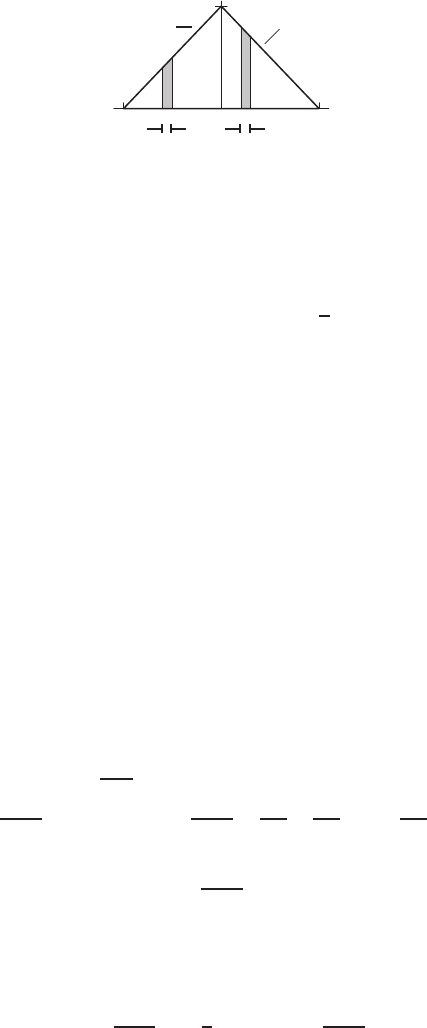
8.4 SOLUTIONS 761
−1✲ ✛
∆x
✲ ✛
∆x
1
1
✲
y=x+ 1 ✠y=−x+ 1
x
y
Figure 8.72
14. Since the density δ(y) = 2 + y2is constant for fixed y, we take slices parallel to the x-axis of height ∆yand length 2.
Then a slice has area = 2∆yand approximate mass of (2 + y2)·2∆y. Adding the slices and letting ∆y→0gives
Mass = Z3
0
2(2 + y2)dy = 4y+2
3y3
3
0
=30 gm.
15. (a) We must find where the population density is zero. The density is given by the function
10,000(3 −r);
if 10,000(3 −r) = 0, then we must have r= 3. We thus conclude that the radius of Circle City is 3miles. (Note that
for r > 3,10,000(3−r)becomes negative, so at that point, our function no longer gives a meaningful representation
of population density.)
(b) We refer to Example 4 in this section, with f(r) = 10,000(3 −r). The population is approximated by a sum
Population ≈X2πr·10,000(3 −r)∆r.
Since the city radius is 3 miles, rranges from 0to 3. Hence as ∆r→0, the sum is given by the integral
Population =Z3
0
2πr·10,000(3 −r)dr.
This integral evaluates to 9π·10,000 ≈282,743. So we can say that the population of Circle City is approximately
282,743.
16. (a) Partition [0,10,000] into Nsubintervals of width ∆r. The area in the ith subinterval is ≈2πri∆r. So the total mass
in the slick =M≈PN
i=12πri50
1+ri∆r.
(b) M=Z10,000
0
100πr
1 + rdr. We may rewrite r
1 + ras 1+r
1+r−1
1+r= 1 −1
1+r, so that
M=Z10,000
0
100π(1 −1
1 + r)dr = 100π r−ln |1 + r|
10,000
0!
= 100π(10,000 −ln(10,001)) ≈3.14 ×106kg.
(c) We wish to find an Rsuch that
ZR
0
100πr
1 + rdr =1
2Z10,000
0
100πr
1 + rdr ≈1.57 ×106.
So 100π(R−ln |R+ 1|)≈1.57 ×106;R−ln |R+ 1| ≈ 5000.By trial and error, we find R≈5009 meters.
17. (a) We form a Riemann sum by slicing the region into concentric rings of radius rand width ∆r. Then the volume
deposited on one ring will be the height H(r)multiplied by the area of the ring. A ring of width ∆rwill have an area
given by
Area =π(r+ ∆r)2−π(r2)
=π(r2+ 2r∆r+ (∆r)2−r2)
=π(2r∆r+ (∆r)2).
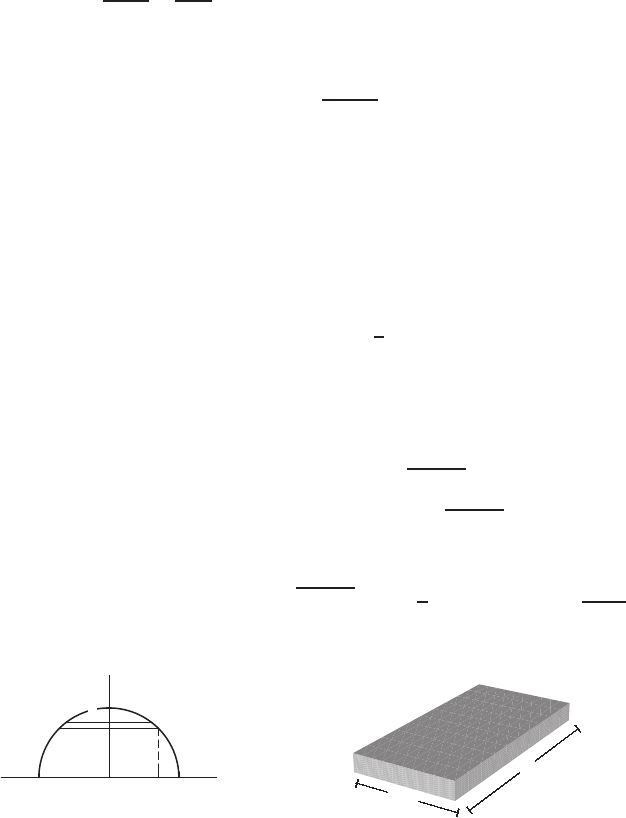
762 Chapter Eight /SOLUTIONS
Since ∆ris approaching zero, we can approximate
Area of ring ≈π(2r∆r+ 0) = 2πr∆r.
From this, we have
∆V≈H(r)·2πr∆r.
Thus, summing the contributions from all rings we have
V≈XH(r)·2πr∆r.
Taking the limit as ∆r→0, we get
V=Z5
0
2πr0.115e−2rdr.
(b) We use integration by parts:
V= 0.23πZ5
0re−2rdr
=0.23πre−2r
−2−e−2r
4
5
0
≈0.181(millimeters)·(kilometers)2= 0.181 ·10−3·106meters3= 181 cubic meters.
18. Partition a≤x≤binto Nsubintervals of width ∆x=(b−a)
N;a=x0< x1<···< xN=b. The mass of the
strip on the ith subinterval is approximately mi=δ(xi)[f(xi)−g(xi)]∆x. If we use a right-hand Riemann sum, the
approximation for the total mass is
N
X
i=1
δ(xi)[f(xi)−g(xi)]∆x, and the exact mass is M=Zb
a
δ(x)[f(x)−g(x)]dx.
19. (a) Use the formula for the volume of a cylinder:
Volume =πr2l.
Since it is only a half cylinder
Volume of shed =1
2πr2l.
(b) Set up the axes as shown in Figure 8.73. The density can be defined as
Density =ky.
Now slice the sawdust horizontally into slabs of thickness ∆yas shown in Figure 8.74, and calculate
Volume of slab ≈2xl∆y= 2l(pr2−y2)∆y.
Mass of slab =Density ·Volume ≈2klypr2−y2∆y.
Finally, we compute the total mass of sawdust:
Total mass of sawdust =Zr
0
2klypr2−y2dy =−2
3kl(r2−y2)3/2
r
0
=2klr3
3.
−rx r
r
x
y
Figure 8.73
✛
✛
l
✛
✛
2x
∆y
Figure 8.74

8.4 SOLUTIONS 763
20. First we rewrite the chart, listing the density with the corresponding distance from the center of the earth (xkm below the
surface is equivalent to 6370 −xkm from the center):
This gives us spherical shells whose volumes are 4
3π(r3
i−r3
i+1)for any two consecutive distances from the origin.
We will assume that the density of the earth is increasing with depth. Therefore, the average density of the ith shell is
between Diand Di+1, the densities at top and bottom of shell i. So 4
3πDi+1(r3
i−r3
i+1)and 4
3πDi(r3
i−r3
i+1)are upper
and lower bounds for the mass of the shell.
Table 8.6
i xiri= 6370 −xiDi
0 0 6370 3.3
1 1000 5370 4.5
2 2000 4370 5.1
3 2900 3470 5.6
4 3000 3370 10.1
5 4000 2370 11.4
6 5000 1370 12.6
7 6000 370 13.0
8 6370 0 13.0
To get a rough approximation of the mass of the earth, we don’t need to use all the data. Let’s just use the densities
at x= 0, 2900, 5000 and 6370 km. Calculating an upper bound on the mass,
MU=4
3π[13.0(13703−03) + 12.6(34703−13703) + 5.6(63703−34703)] ·1015 ≈7.29 ×1027 g.
The factor of 1015 may appear unusual. Remember the radius is given in kilometers and the density is given in g/cm3, so
we must convert kilometers to centimeters: 1km = 105cm , so 1km3= 1015 cm3.
The lower bound is
ML=4
3π[12.6(13703−03) + 5.6(34703−13703) + 3.3(63703−34703)] ·1015 ≈4.05 ×1027 g.
Here, our upper bound is just under 2 times our lower bound.
Using all our data, we can find a more accurate estimate. The upper and lower bounds are
MU=4
3π
7
X
i=0
Di+1(r3
i−r3
i+1)·1015 g
and
ML=4
3π
7
X
i=0
Di(r3
i−r3
i+1)·1015 g.
We have
MU=4
3π[4.5(63703−53703) + 5.1(53703−43703) + 5.6(43703−34703)
+ 10.1(34703−33703) + 11.4(33703−23703) + 12.6(23703−13703)
+ 13.0(13703−3703) + 13.0(3703−03)] ·1015 g
≈6.50 ×1027 g
and
ML=4
3π[3.3(63703−53703) + 4.5(53703−43703) + 5.1(43703−34703)
+ 5.6(34703−33703) + 10.1(33703−23703) + 11.4(23703−13703)
+ 12.6(13703−3703) + 13.0(3703−03)] ·1015 g
≈5.46 ×1027 g.

764 Chapter Eight /SOLUTIONS
21. We slice time into small intervals. Since tis given in seconds, we convert the minute to 60 seconds. We consider water
loss over the time interval 0≤t≤60. We also need to convert inches into feet since the velocity is given in ft/sec. Since
1 inch = 1/12 foot, the square hole has area 1/144 square feet. For water flowing through a hole with constant velocity v,
the amount of water which has passed through in some time, ∆t, can be pictured as the rectangular solid in Figure 8.75,
which has volume
Area ·Height =Area ·Velocity ·Time.
❄❄❄
Area
=1
144
ft
2
❄
Height
=g(t)∆t✲
Figure 8.75
: Volume of water passing
through hole
Over a small time interval of length ∆t, starting at time t, water flows with a nearly constant velocity v=g(t)
through a hole 1/144 square feet in area. In ∆tseconds, we know that
Water lost ≈1
144 ft2(g(t)ft/sec)(∆tsec) = 1
144 g(t) ∆tft3.
Adding the water from all subintervals gives
Total water lost ≈X1
144 g(t) ∆tft3.
As ∆t→0, the sum tends to the definite integral:
Total water lost =Z60
0
1
144 g(t)dt ft3.
22. (a) Divide the atmosphere into spherical shells of thickness ∆h. See Figure 8.76. The density on a typical shell, ρ(h), is
approximately constant. The volume of the shell is approximately the surface area of a sphere of radius re+hmeters
times ∆h, where re= 6.4·106meters is the radius of the earth,
Volume of Shell ≈4π(re+hi)2∆h.
A Riemann sum for the total mass is
Mass ≈X4π(re+h)2×1.28e−0.000124hi∆hkg.
ith spherical shell
re+h
∆h
Earth
Figure 8.76
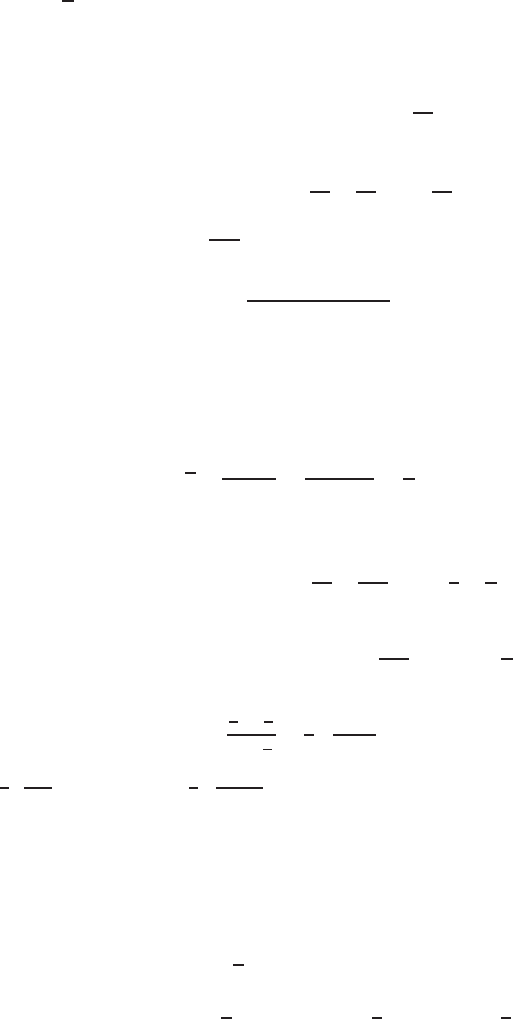
8.4 SOLUTIONS 765
(b) This Riemann sum becomes the integral
Mass = 4πZ100
0
(re+h)2·1.28e−0.000124hdh
= 4πZ100
0
(6.4·106+h)2·1.28e−0.000124hdh.
Evaluating the integral using numerical methods gives M= 6.5·1016 kg.
23. We need the numerator of x, to be zero, i.e. Pximi= 0.Since all of the masses are the same, we can factor them out
and write 4Pxi=0.Thus the fourth mass needs to be placed so that all of the positions sum to zero. The first three
positions sum to (−6 + 1 + 3) = −2,so the fourth mass needs to be placed at x= 2.
24. We have
Total mass of the rod =Z3
0
(1 + x2)dx =x+x3
3
3
0
= 12 grams.
In addition,
Moment =Z3
0
x(1 + x2)dx =x2
2+x4
4
3
0
=99
4gram-meters.
Thus, the center of mass is at the position ¯x=99/4
12 = 2.06 meters.
25. The center of mass is
¯x=Rπ
0x(2 + sin x)dx
Rπ
0(2 + sin x)dx .
The numerator is Rπ
0(2x+xsin x)dx = (x2−xcos x+ sin x)
π
0
=π2+π.
The denominator is Rπ
0(2 + sin x)dx = (2x−cos x)
π
0
= 2π+ 2.So the center of mass is at
x=π2+π
2π+ 2 =π(π+ 1)
2(π+ 1) =π
2.
26. (a) We find that
Moment =Z1
0
x(1 + kx2)dx =x2
2+kx4
4
1
0
=1
2+k
4gram-meters,
and that
Total mass =Z1
0
(1 + kx2)dx =x+kx3
3
1
0
= 1 + k
3grams.
Thus, the center of mass is
¯x=
1
2+k
4
1 + k
3
=3
42 + k
3 + kmeters.
(b) Let f(k) = 3
42+k
3+k. Then f′(k) = 3
41
(3+k)2, which is always positive, so fis an increasing function of k.
Since f(0) = 0.5, this is the smallest value of f. As k→ ∞,f(k)→3/4 = 0.75. So f(k)is always between 0.5
and 0.75.
27. (a) The density is minimum at x=−1and increases as xincreases, so more of the mass of the rod is in the right half of
the rod. We thus expect the balancing point to be to the right of the origin.
(b) We need to compute
Z1
−1
x(3−e−x)dx =3
2x2+xe−x+e−x
1
−1
(using integration by parts)
=3
2+e−1+e−1−3
2−e1+e1=2
e.

766 Chapter Eight /SOLUTIONS
We must divide this result by the total mass, which is given by
Z1
−1
(3 −e−x)dx = (3x+e−x)
1
−1
= 6 −e+1
e.
We therefore have
¯x=2/e
6−e+ (1/e)=2
1 + 6e−e2≈0.2.
28. Since the region is symmetric about the x-axis, ¯y= 0.
To find ¯x, we first find the density. The area of the disk is π/2m2, so it has density 3/(π/2) = 6/π kg/m2. We find
the mass of the small strip of width ∆xin Figure 8.77. The height of the strip is √1−x2, so
Area of the small strip ≈Ax(x)∆x= 2 ·p1−x2∆xm2.
When multiplied by the density 6/π, we get
Mass of the strip ≈12
π·p1−x2∆xkg.
We then sum the product of these masses with x, and take the limit as ∆x→0to get
Moment =Z1
0
12
πxp1−x2dx =−4
π(1 −x2)3/2
1
0
=4
πmeter.
Finally, we divide by the total mass 3kg to get the result ¯x= 4/(3π)meters.
✻
❄
✲
√1−x2
✠∆x
1
−1
1
x
y
Figure 8.77
: Area of a small strip
29. (a) Since the density is constant, the mass is the product of the area of the plate and its density.
Area of the plate =Z1
0
x2dx =1
3x3
1
0
=1
3cm2.
Thus the mass of the plate is 2·1/3 = 2/3gm.
(b) See Figure 8.78. Since the region is “fatter” closer to x= 1,¯xis greater than 1/2.
✲ ✛
∆x
1
x2
x
y
Figure 8.78
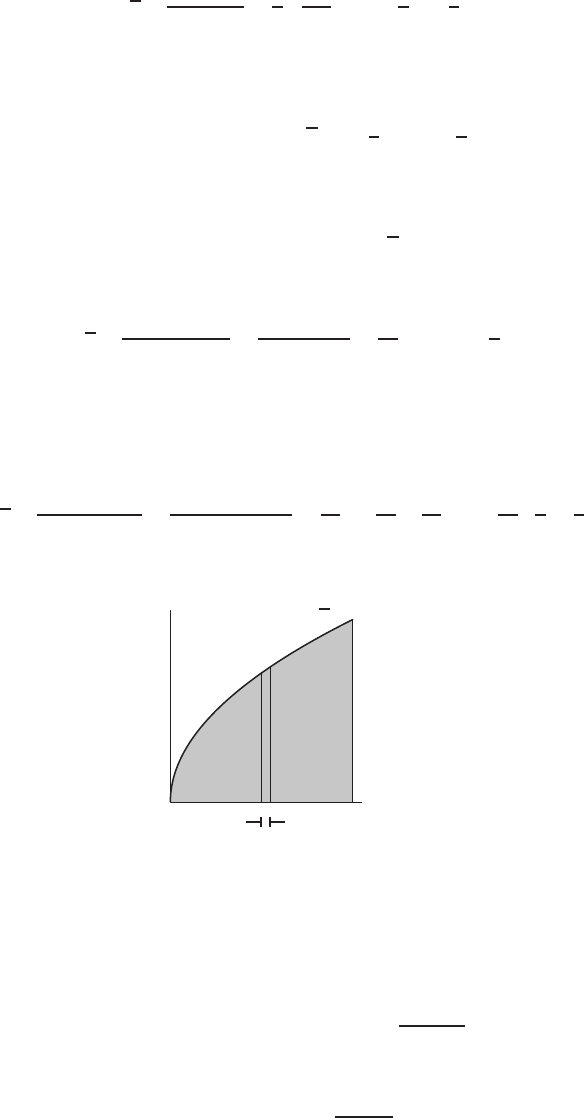
8.4 SOLUTIONS 767
(c) To find the center of mass along the x-axis, we slice the region into vertical strips of width ∆x. See Figure 8.78. Then
Area of strip =Ax(x)∆x≈x2∆x
Then, since the density is 2gm/cm2, we have
x=R1
02x3dx
2/3=3
2·2x4
4
1
0
= 3 1
4=3
4cm.
This is greater than 1/2, as predicted in part (b).
30. (a) Since the density is constant, the mass is the product of the area of the plate and its density.
Area of the plate =Z1
0
√x dx =2
3x3/2
1
0
=2
3cm2.
Thus the mass of the plate is 5·2/3 = 10/3gm.
(b) To find ¯x, we slice the region into vertical strips of width ∆x. See Figure 8.79. Then
Area of strip =Ax(x)∆x≈√x∆xcm2.
Then, since the density is 5gm/cm2, we have
x=RxδAx(x)dx
Mass =R1
05x3/2dx
10/3=3
10 2x5/21
0=3
5cm.
To find ¯y, we slice the region into horizontal strips of width ∆y
Area of horizontal strip =Ay(y)∆y≈(1 −x)∆y= (1 −y2)∆ycm2.
Then, since the density is 5gm/cm2, we have
y=RyδAy(y)dy
Mass =R1
05(y−y3)dy
10/3=3
10 5y2
2−y4
4
1
0
=3
10 ·5
4=3
8cm.
✲ ✛
∆x
1
√x
x
y
Figure 8.79
31. The triangle is symmetric about the xaxis, so ¯y= 0.
To find ¯x, we first calculate the density. The area of the triangle is ab/2, so it has density 2m/(ab)where mis the
total mass of the triangle. We need to find the mass of a small strip of width ∆xlocated at xi(see Figure 8.80).
Area of the small strip ≈Ax(x)∆x= 2 ·b(a−x)
2a∆x.
Multiplying by the density 2m/(ab)gives
Mass of the strip ≈2m(a−x)
a2∆x.
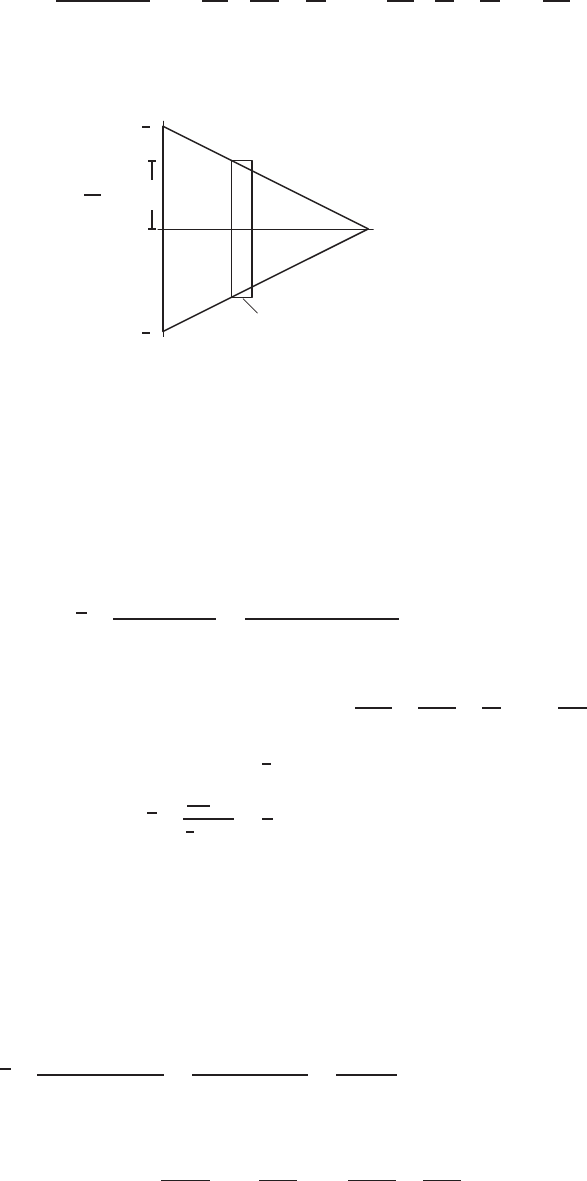
768 Chapter Eight /SOLUTIONS
We then sum the product of these masses with xi, and take the limit as ∆x→0to get
Moment =Za
0
2mx(a−x)
a2dx =2m
a2ax2
2−x3
3
a
0
=2m
a2a3
2−a3
3=ma
3.
Finally, we divide by the total mass mto get the desired result ¯x=a/3, which is independent of the length of the base b.
x ax
y
−b
2
b
2
✻
❄
b
2a(a−x)
■∆x
Figure 8.80
32. Stand the cone with the base horizontal, with center at the origin. Symmetry gives us that ¯x= ¯y= 0. Since the cone is
fatter near its base we expect the center of mass to be nearer to the base.
Slice the cone into disks parallel to the xy-plane.
As we saw in Example 3 on page 416, a disk of thickness ∆zat height zabove the base has
Volume of disk =Az(z)∆z≈π(5 −z)2∆zcm3.
Thus, since the density is δ,
z=RzδAz(z)dz
Mass =R5
0z·δπ(5 −z)2dz
Mass cm.
To evaluate the integral in the numerator, we factor out the constant density δand πto get
Z5
0
z·δπ(5 −z)2dz =δπ Z5
0
z(25 −10z+z2)dz =δπ 25z2
2−10z3
3+z4
4
5
0
=625
12 δπ.
We divide this result by the total mass of the cone, which is 1
3π52·5δ:
z=
625
12 δπ
1
3π53δ=5
4= 1.25 cm.
As predicted, the center of mass is closer to the base of the cone than its top.
33. Since the density is constant, the total mass of the solid is the product of the volume of the solid and its density: δπ(1 −
e−2)/2.By symmetry, ¯y= 0. To find ¯x, we slice the solid into disks of width ∆x, perpendicular to the x-axis. See
Figure 8.81. A disk at xhas radius y=e−x, so
Volume of disk =Ax(x)∆x=πy2∆x=πe−2x∆x.
Since the density is δ, we have
x=R1
0x·δπe−2xdx
Total mass =δπ R1
0xe−2xdx
δπ(1 −e−2)/2=2
1−e−2Z1
0
xe−2xdx.
The integral Rxe−2xdxcan be done by parts: let u=xand v′=e−2x.Then u′= 1 and v=e−2x/(−2).So
Zxe−2xdx =xe−2x
−2−Ze−2x
−2dx =xe−2x
−2−e−2x
4.
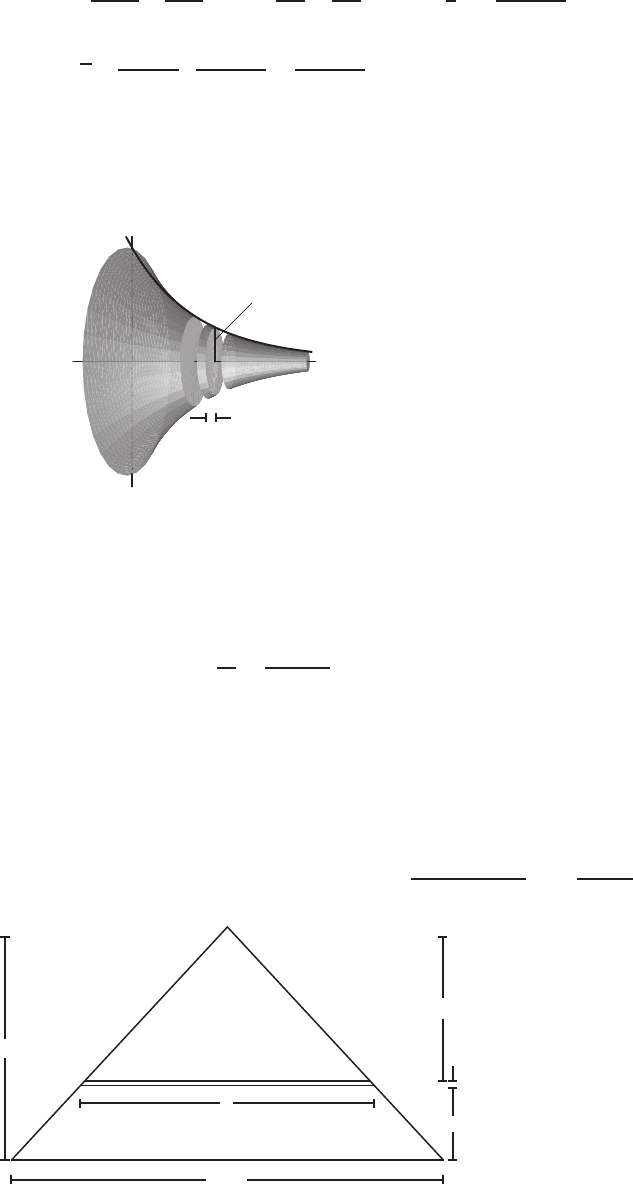
8.4 SOLUTIONS 769
and then Z1
0
xe−2xdx =xe−2x
−2−e−2x
4
1
0
=e−2
−2−e−2
4−0−1
4=1−3e−2
4.
The final result is:
x=2
1−e−2·1−3e−2
4=1−3e−2
2−2e−2≈0.343.
Notice that ¯xis less that 1/2, as we would expect from the fact that the solid is wider near the origin.
x
y
y=e−x
✲ ✛
∆x
✠
Radius
=y
Figure 8.81
34. (a) Position the pyramid so that the center of its base lies at the origin on the xy-plane. Slice the pyramid into square
slabs parallel to its base. We compute the mass of the pyramid by adding the masses of the slabs.
The mass of a slab is its volume multiplied by the density δ. To compute the volume of a slab, we need to get an
expression for the side sof the slab in terms of its height z. Using the similar triangles in Figure 8.82, we see that
s
40 =(10 −z)
10 .
Thus s= 4(10 −z).Since the area of the square slab’s face is s2,
Volume of the slab ≈Az(z)∆z=s2∆z= 16(10 −z)2∆z.
Mass of slab = 16δ(10 −z)2∆z.
The mass of the pyramid can be found by summing all of the masses of the slabs, and letting the thickness ∆z
approach zero:
Total mass = lim
∆z→0X16δ(10 −z)2∆z=Z10
0
16δ(10 −z)2dz =−16δ(10 −z)3
3
10
0
=16000δ
3gm.
✻
❄
10
cm
✲✛ s
✲✛ 40
cm
✻
❄
10 −z
✻
❄
z
✻
❄
∆z
Figure 8.82
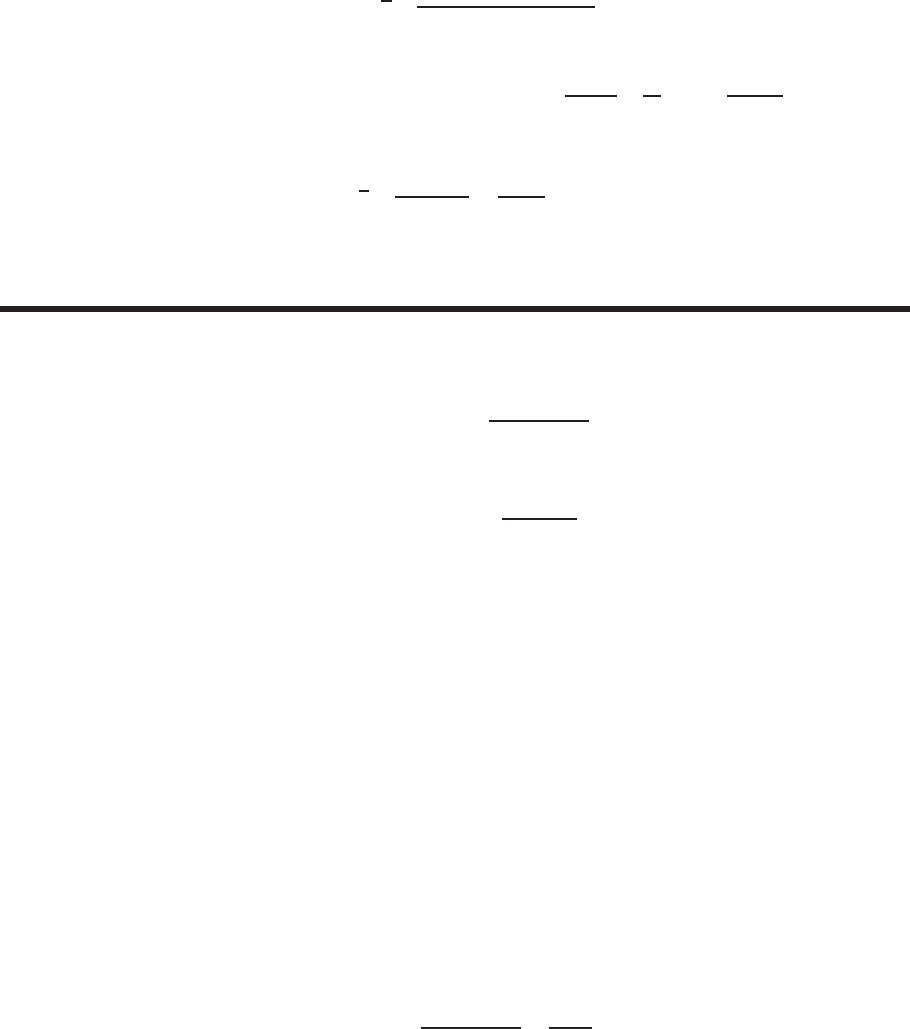
770 Chapter Eight /SOLUTIONS
(b) From symmetry, we have ¯x= ¯y= 0. Since the pyramid is fatter near its base we expect the center of mass to be
nearer to the base. Since
Volume of slab =Az(z)∆z= 16(10 −z)2∆z,
z=R10
0z·16δ(10 −z)2dz
Total mass .
To evaluate the integral in the numerator, we factor out the constant 16δand expand the integrand to get
16δZ10
0
(100z−20z2+z3)dz = 16δ50z2+−20z3
3+z4
4
10
0
=40000δ
3.
We divide this result by the total mass 16000δ/3of the pyramid
z=40000δ/3
16000δ/3=40000
16000 = 2.5cm.
As predicted, the center of mass is closer to the base of the pyramid than its top.
Strengthen Your Understanding
35. Mass density can never be negative, but f(x)<0for 0< x < 5.
36. The center of mass with density δ(x)for 0≤x≤10 is given by
Center of mass =R10
0xδ(x)dx
R10
0δ(x)dx .
The correct formula for δ(x) = x2is
Center of mass =R10
0x3dx
R10
0x2dx .
37. Any density function that is symmetric about the center of the rod will also give a center of mass in the center of the rod.
For example, if a rod has ends at x=−1and x= 1 and density δ(x) = x2then its center of mass is at the origin.
38. When the density is constant, for example, if δ(r) = 3 everywhere on the disk, the mass of the disk is the density times
the area of the disk, or 3·9π= 27πgm. Since the density is not constant and is less than 3everywhere except at the
center of the disk, the mass of the disk must be less than 27πgm.
39. Let the rod be the interval 0≤x≤10. Suppose the density is given by
δ(x) = (5,0≤x≤1
1,1<x < 5
4,5≤x≤10
.
The rod is denser at the end x= 0 than at the end x= 10.
We have
Z10
0
xδ(x)dx =Z1
0
5x dx +Z5
1
x dx +Z10
5
4x dx = 2.5 + 12 + 150 = 164.5
Z10
0
δ(x)dx=Z1
0
5dx +Z5
1
1dx +Z10
5
4dx = 5 + 4 + 20 = 29.
Therefore
Center of Mass =R10
0xδ(x)dx
R10
0δ(x)dx =164.5
29 = 5.672.
The center of mass at x= 5.672 is nearer to the end x= 10 than to the end x= 0.

8.5 SOLUTIONS 771
40. Any rod whose mass increases towards one end will skew the center of mass towards that end. As an example, if δ(x) = x,
then the total mass of the rod is
Mass = Z2
0
x dx = 2
and the center of mass is
Center of mass = 1
2Z2
0
x·δ(x)dx =1
2·x3
3
2
0
=4
3cm
which is not at the center of the rod.
41. Taking a constant density δ(x) = 1 gives the desired result, since then the center of mass is
Center of mass = R2
0x·δ(x)dx
R2
0δ(x)dx =2
2= 1 cm.
42. False. The population density needs to be approximately constant on each ring. This is only true if the population density
is a function of r, the distance from the center of the city.
43. False. Since the density varies with y, the region must be sliced perpendicular to the y-axis, along the lines of constant y.
44. False. Although the density is greater near the center, the area of the suburbs is much larger than the area of the inner city,
and population is determined by both area and density. In fact, the population of the inner city:
Z1
0
(10 −3r)2πr dr = 2π(5r2−r3)
1
0
= 8π
is less than the population of the suburbs:
Z2
1
(10 −3r)2πr dr = 2π(5r2−r3)
2
1
= 16π.
45. True. One way to look at it is that the center of mass should not change if you change the units by which you measure the
masses. If you double the masses, that is no different than using as a new unit of mass half the old unit. Alternatively, let
the masses be m1, m2, and m3located at x1, x2, and x3. Then the center of mass is given by:
¯x=x1m1+x2m2+x3m3
m1+m2+m3
.
Doubling the masses does not change the center of mass, since it doubles both the numerator and the denominator.
46. False. The center of mass of a circular ring (for example, a coin with a hole in it) is at the center.
47. True. The density of particles hitting the target is approximately constant on concentric rings.
48. False. If the density were constant this would be true, but suppose that all the mass on the left half is concentrated at x= 0
and all the mass on the right side is concentrated at x= 3. In order for the rod to balance at x= 2, the weight on the left
side must be half the weight on the right side.
Solutions for Section 8.5
Exercises
1. This is in British units, so the distance raised, d, is first converted to feet: d= 0.75. feet.
Work done =F·d= 40 lb ·0.75 ft = 30 ft-lb.
2. This is in International units, so the distance raised, d, is first converted to meters: d= 0.3m. The force due to gravity is
mg = (20 kg)(gm/sec2), so
W=F·d= [(20 kg)(9.8m/sec2)] ·(0.3m) = 58.8joules.

772 Chapter Eight /SOLUTIONS
3. Because the force is a function F(x)of position x, then in moving from x=ato x=b,
Work done =Zb
a
F(x)dx.
In this case
Work done =Z1
0
x2+2x dx =1
3x3+x2
1
0
= 1.333 ft-lb.
4. The work done is given by
W=Z2
1
3xdx =3
2x2
2
1
=9
2joules.
5. The work done is given by
W=Z3
0
3x dx =3
2x2
3
0
=27
2joules.
6. (a) For compression from x= 0 to x= 1,
Work =Z1
0
3xdx =3
2x2
1
0
=3
2= 1.5joules.
For compression from x= 4 to x= 5,
Work =Z5
4
3xdx =3
2x2
5
4
=3
2(25 −16) = 27
2= 13.5joules.
(b) The second answer is larger. Since the force increases with x, for a given displacement, the work done is larger for
larger xvalues. Thus, we expect more work to be done in moving from x= 4 to x= 5 than from x= 0 to x= 1.
7. Since all parts of the plate are at the same depth, the force is constant on all parts of the plate. The force is the pressure,
62.4·150 lb/ft2multiplied by the area of the plate, 400πft2,so
Force = 1.176 ·107pounds.
8. Because the bottom of the fish tank is horizontal, the pressure is the same at every point on the bottom, so
Pressure = 62.4lb/ft3·1ft = 62.4lb/ft2.
and
Force =Pressure ·Area = 62.4lb/ft2·2ft ·1ft = 124.8pounds.
9. The only work is done by lifting the bucket initially, since the motion is parallel to the force of gravity, so the work is
2·10 = 20 ft-lb. When the child is walking and holding the bucket at a constant height, the force of gravity and the
motion are at right angles, and the work done is zero. Thus, the total work done is 20 ft-lb.
10. Since the gravitational force is
F=4·1014
r2newtons
and rvaries between 6.4·106and 7.4·106meters,
Work done =Z7.4·106
6.4·106
4·1014
r2dr =−4.1014 1
r
7.4·106
6.4·106
= 4 ·1014 1
6.4·106−1
7.4·106= 8.4·106joules.
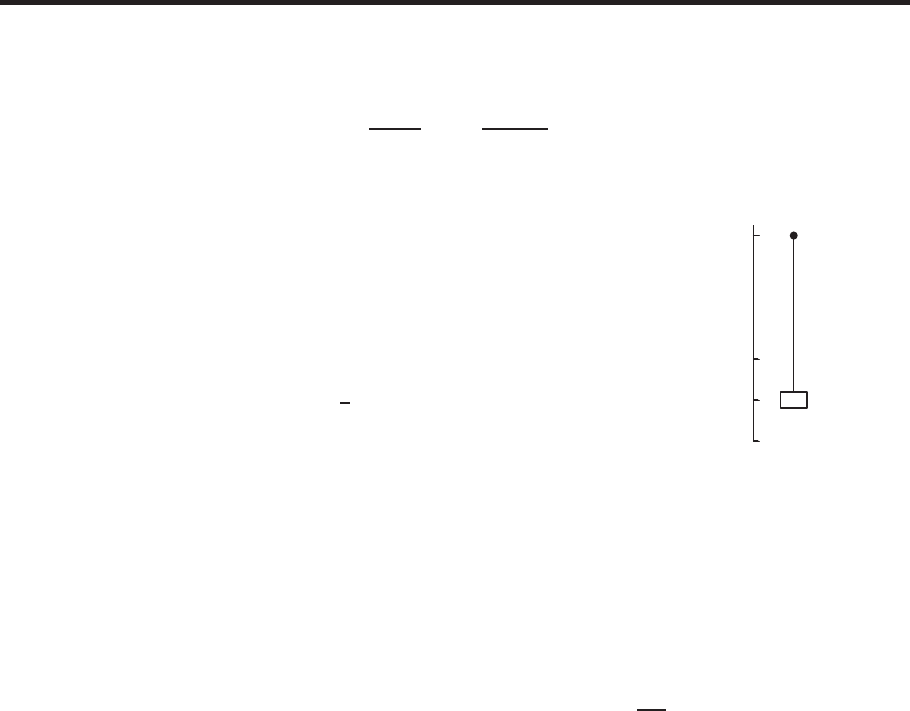
8.5 SOLUTIONS 773
Problems
11. The force exerted on the satellite by the earth (and vice versa!) is GMm/r2, where ris the distance from the center of
the earth to the center of the satellite, mis the mass of the satellite, Mis the mass of the earth, and Gis the gravitational
constant. So the total work done is
Z8.4·106
6.4·106
F dr =Z8.4·106
6.4·106
GMm
r2dr =−GMm
r
8.4·106
6.4·106≈1.489 ·1010 joules.
12. Let xbe the distance from ground to the bucket of cement.
At height x, if the bucket is lifted by ∆x, the work done is
500∆x+0.5(75−x)∆x. See Figure 8.83. The 500∆xterm
is due to the bucket of cement; the 0.5(75 −x)∆xterm is
due to the remaining cable. So the total work, W, required
to lift the bucket is
W=Z30
0
500dx +Z30
0
0.5(75 −x)dx
= 500 ·30 + 0.5(75 ·30 −1
2302)
= 15,900 ft-lb. 0
x
30
75
500
height
Figure 8.83
13. When the anchor has been lifted through hfeet, the length of chain in the water is 25 −hfeet, so the total weight of the
anchor and chain in the water is 50 + 3(25 −h)lb. Then
Work to lift the anchor and chain ∆hhigher =Weight ·Distance lifted
= (100 + 3(25 −h))∆h.
To find the total work, we integrate from h= 0 to h= 25:
W=Z25
0
(100 + 3(25 −h))dh =Z25
0
(175 −3h)dh =175h−3h2
2
25
0
=3437.5ft-lbs.
14. To lift the weight an additional height ∆hoff the ground from a height of h, we must do work on the weight and the amount
of rope not yet pulled onto the roof. Since the roof is 30 ft off the ground, there will be 30 −hfeet remaining of rope, for
a weight of 4(30 −h). So the work required to raise the weight and the rope a height ∆hwill be ∆h(1000 + 4(30 −h)).
To find the total work, we integrate this quantity from h= 0 to h= 10:
Work =Z10
0
(1000 + 4(30 −h)) dh
=Z10
0
(1120 −4h)dh
= (1120h−2h2)
10
0
= 11,200 −200
= 11,000 ft-lbs.
15. The bucket moves upward at 40/10 = 4 meters/minute. If time is in minutes, at time tthe bucket is at a height of x= 4t
meters above the ground. See Figure 8.84.
The water drips out at a rate of 5/10 = 0.5kg/minute. Initially there is 20 kg of water in the bucket, so at time t
minutes, the mass of water remaining is
m= 20 −0.5tkg.

774 Chapter Eight /SOLUTIONS
Consider the time interval between tand t+ ∆t. During this time the bucket moves a distance ∆x= 4∆tmeters. So,
during this interval,
Work done ≈mg∆x= (20 −0.5t)g4∆tjoules.
Total work done = lim
∆t→0X(20 −0.5t)g4∆t= 4gZ10
0
(20 −0.5t)dt
= 4g(20t−0.25t2)
10
0
= 700g= 700(9.8) = 6860 joules.
x
✻
❄
40
m
Platform
Ground
Figure 8.84
16. Let xbe the height (in feet) from ground to the cube of ice. It follows that 0≤x≤100. At height x, the ice cube w
weighs 2000 −4xsince it’s being lifted at a rate 1 ft./min. and it’s melting at a rate of 4 lb/min. To lift it ∆xmore the
work required is (2000 −4x)∆x. So the total work done is
W=Z100
0
(2000 −4x)dx
=2000x−2x2
100
0
= 2000(100) −2·(100)2
= 180,000 ft-lb.
17. Let yrepresent depth below the surface of the can. Slice the water in the can horizontally into cylinders of height ∆y
and radius 1. See Figure 8.85. To find the weight of such a slice, we multiply its volume by its weight per cubic foot: we
obtain
Weight =π12(∆y)(62.4) ≈196.04 ∆y.
So the work required to lift a slice at depth yto the surface is 196.04y∆y.
To find the total work required to empty the can, we integrate:
Total Work ≈Z3
1
196.04y dy = 196.04 y2
2
3
1≈784.14 ft-lb.
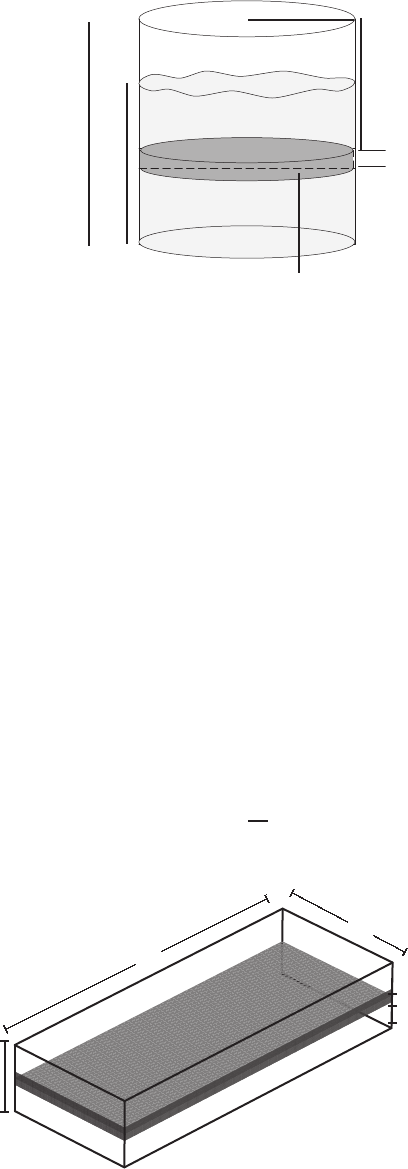
8.5 SOLUTIONS 775
❄
✻
❄
✻
✲
❄
✻
✻
Volume of Slice =π∆y
1′
2′
3′
y
∆y
Figure 8.85
18. We slice the water horizontally and find the work required to pump each horizontal slice of water over the top. See
Figure 8.86. At a distance hft above the bottom, a slice of thickness ∆hhas
Volume ≈50 ·20∆hft3.
Since the density of water is ρlb/ft3,
Weight of the slice ≈ρ(50 ·20 ·∆h)lbs.
The distance to lift the slice of water at height hft is 10 −hft, so
Work to move one slice =ρ·Volume ·Distance lifted
≈ρ(50 ·20 ·∆h)(10 −h)
= 100ρ(10 −h)∆hft-lb.
The work done, W, to pump all the water is the sum of the work done on the pieces:
W≈X100ρ(10 −h)∆h.
As ∆h→0, we obtain a definite integral. Since hvaries from h= 0 to h= 9 and ρ= 62.4lb/ft3, the total work is:
W=Z9
0
100ρ(10 −h)dh = 62400 10h−h2
2
9
0
= 62400(49.5) = 3,088,800.
The work to pump all the water out is 3,088,800 ft-lbs.
✻
❄
10
ft
✻
❄
h
ft
✻
❄
∆h
✛
✛20
ft
✛
✛
50
ft
Figure 8.86
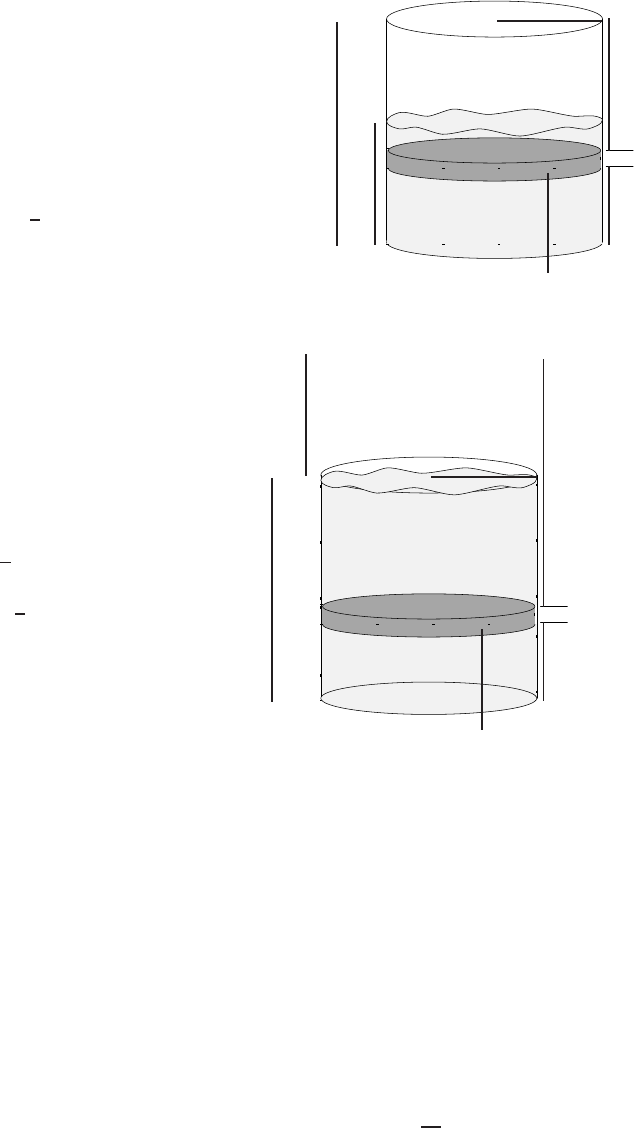
776 Chapter Eight /SOLUTIONS
19. Let xbe the distance measured from the bottom
the tank. See Figure 8.87. To pump a layer of wa-
ter of thickness ∆xat xfeet from the bottom, the
work needed is
(62.4)π62(20 −x)∆x.
Therefore, the total work is
W=Z10
0
36·(62.4)π(20 −x)dx
= 36 ·(62.4)π(20x−1
2x2)
10
0
= 36 ·(62.4)π(200 −50)
≈1,058,591.1ft-lb.
❄
✻
❄
✻
✲
❄
✻
❄
✻
✻x
20 −x
Volume of Slice =π(62)∆x
∆x
10′
20′
6′
Figure 8.87
20. Let xbe the distance from the bottom of the
tank. See Figure 8.88. To pump a layer of
water of thickness ∆xat xfeet from the
bottom to 10 feet above the tank, the work
done is (62.4)π62(30 −x)∆x. Thus the to-
tal work is
Z20
0
36·(62.4)π(30 −x)dx
= 36 ·(62.4)π30x−1
2x2
20
0
=36 ·(62.4)π(30(20) −1
2202)
≈2,822,909.50 ft-lb.
10′
❄
✻
❄
✻
❄
✻
✲
❄
✻
✻
30 −x
x
V
olume of Slice =π62∆x
∆x
20′
6′
Figure 8.88
21. (a) We slice the water horizontally. Each slice is a cylindrical slab of radius 4 and thickness ∆h, so
Volume of each slab ≈π42∆hft3.
See Figure 8.89. The density of water is δlb/ft3, so
Weight of slab ≈δπ42∆hlb.
Water at a height of hft must be lifted a distance of 10 −hft.
Work to move one slice =δ·Volume ·Distance lifted
≈δ(π(4)2∆h)(10 −h)ft-lb.
Since the density of water is δ= 62.4lb/ft3and since hvaries from h= 0 to h= 10, the total work, W, is:
W=Z10
0
δ(π42)(10 −h)dh = 16δπ Z10
0
(10 −h)dh = 998.4π10h−h2
2
10
0
=156,828 ft-lb.
The total work required is 156,828 ft-lbs.
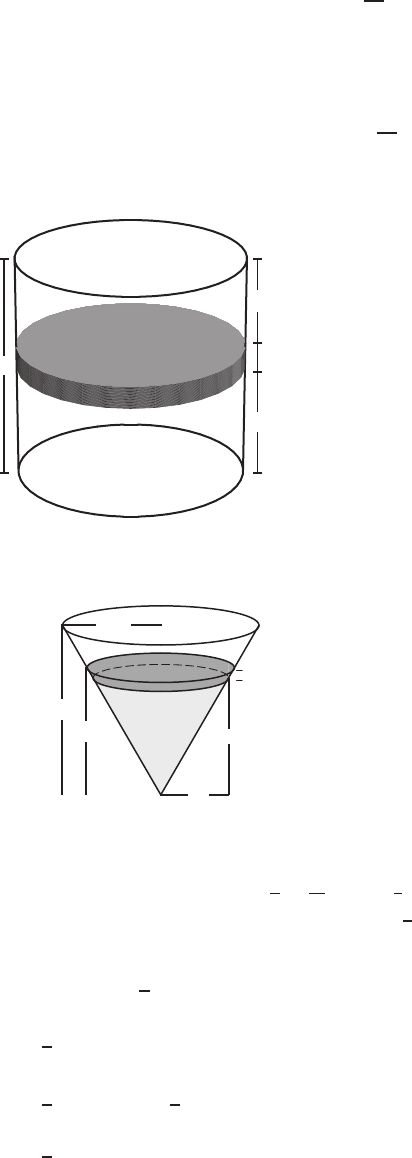
8.5 SOLUTIONS 777
(b) This is the same as part (a) except the water must be lifted a distance of 15 −hft. The total work is:
W=Z10
0
δ(π42)(15 −h)dh = 16δπ Z10
0
(15 −h)dh = 998.4π15h−h2
2
10
0
=313,656 ft-lb.
The total work required is 313,656 ft-lbs.
(c) This is the same as part (a) except that hvaries from h= 0 to h= 8. The total work is:
W=Z8
0
δ(π42)(10 −h)dh = 16δπ Z8
0
(10 −h)dh = 998.4π10h−h2
2
8
0
=150,555.
The total work required is 150,555 ft-lbs.
✻
❄
10
ft
✻
❄
h
✻
❄
∆h
✻
❄
10 −h
Figure 8.89
22. ✛12′
✻
❄
18′
✻
❄
15′
✲
r
✻
❄
x
∆x
Figure 8.90
Let xbe the depth of the water measured from the bottom of the tank. See Figure 8.90. It follows that 0≤x≤15. Let r
be the radius of the section of the cone with height x. By similar triangles, r
x=12
18 , so r=2
3x. Then the work required
to pump a layer of water with thickness of ∆xat depth xover the top of the tank is 62.4π2
3x2∆x(18 −x). So the
total work done by pumping the water over the top of the tank is
W=Z15
0
62.4π2
3x2
(18 −x)dx
=4
962.4πZ15
0
x2(18 −x)dx
=4
962.4π6x3−1
4x4
15
0
=4
962.4π(7593.75) ≈661,619.41 ft-lb.
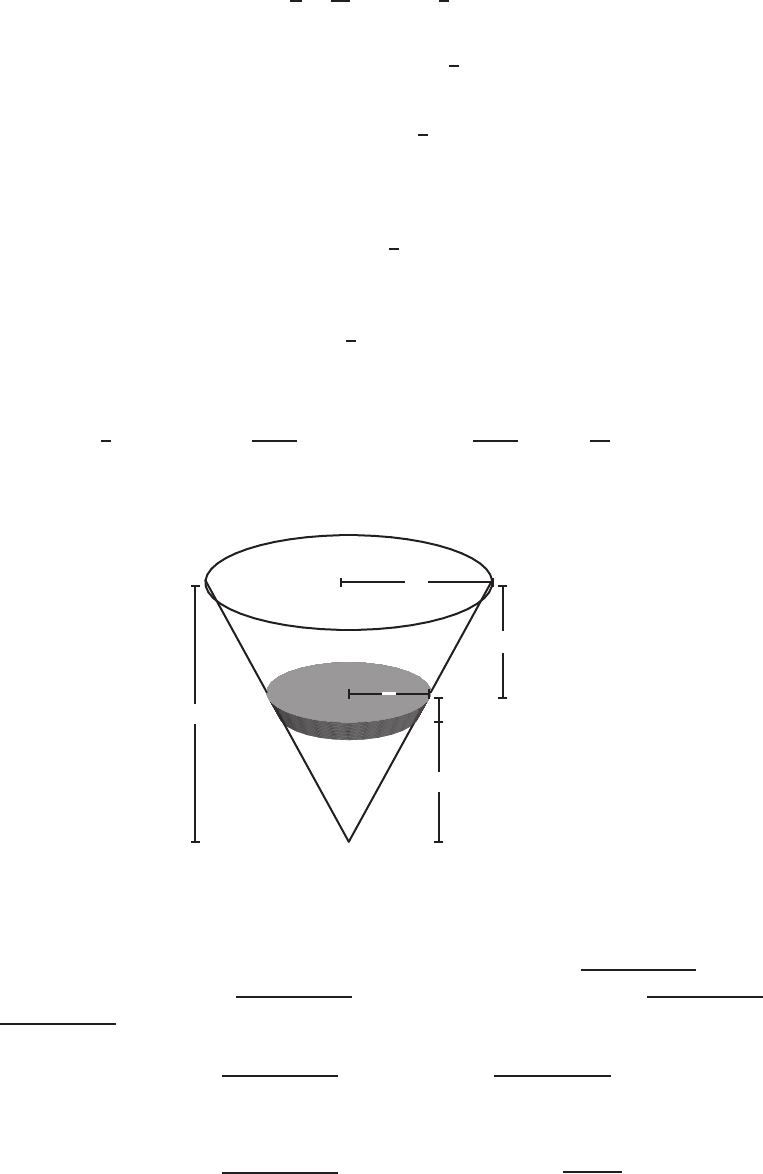
778 Chapter Eight /SOLUTIONS
23. We slice the water horizontally as in Figure 8.91. We use similar triangles to find the radius rof the slice at height hin
terms of h:r
h=4
12 so r=1
3h.
At height h,
Volume of slice ≈πr2∆h=π1
3h2
∆hft3.
The density of water is δlb/ft3, so
Weight of slice ≈δπ 1
3h3
∆hlb.
The water at height hmust be lifted a distance of 12 −hft, so
Work to move slice =δ·Volume ·Distance lifted
≈δπ1
3h2
∆h(12 −h)ft-lb.
The work done, W, to lift all the water is the sum of the work done on the pieces:
W≈Xδπ(1
3h)2∆h(12 −h)ft-lb.
As ∆h→0, we obtain a definite integral. Since hvaries from h= 0 to h= 9, and δ= 62.4, we have:
W=Z9
0
δπ(1
3h)2(12 −h)dh =62.4π
9Z9
0
(12h2−h3)dh =62.4π
94h3−h4
4
9
0
=27,788 ft-lb.
The work to pump all the water out is 27,788 ft-lbs.
✻
❄
12
ft
✻
❄
h
✻
❄
∆h
✻
❄
12 −h
✲✛ r
✲✛ 4
ft
Figure 8.91
24. Let hrepresent distance below the surface in feet. We slice the tank up into horizontal slabs of thickness ∆h. From
looking at Figure 8.92, we can see that the slabs will be rectangular. The length of any slab is 12 feet. The width wof a
slab hunits below the ground will equal 2x, where (14 −h)2+x2= 16, so w= 2p42−(14 −h)2. The volume of
such a slab is therefore 12w∆h= 24p16 −(14 −h)2∆hcubic feet; the slab weighs 42 ·24p16 −(14 −h)2∆h=
1008p16 −(14 −h)2∆hpounds. So the total work done in pumping out all the gasoline is
Z18
10
1008hp16 −(14 −h)2dh = 1008 Z18
10
hp16 −(14 −h)2dh.
Substitute s= 14 −h,ds =−dh. We get
1008 Z18
10
hp16 −(14 −h)2dh =−1008 Z−4
4
(14 −s)p16 −s2ds
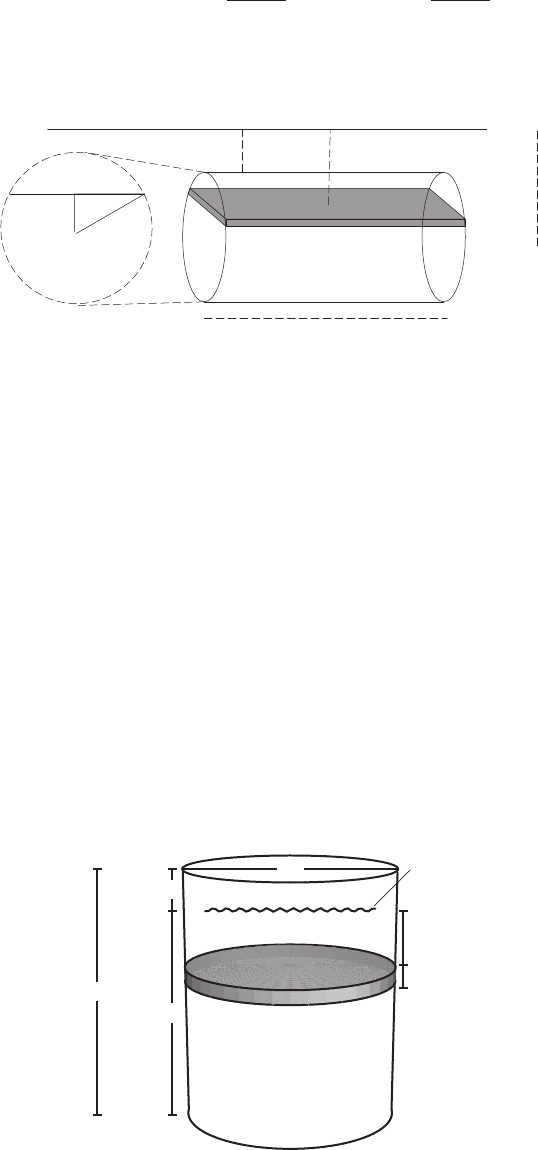
8.5 SOLUTIONS 779
= 1008 ·14 Z4
−4p16 −s2ds −1008 Z4
−4
sp16 −s2ds.
The first integral represents the area of a semicircle of radius 4, which is 8π. The second is the integral of an odd function,
over the interval −4≤s≤4, and is therefore 0. Hence, the total work is 1008 ·14 ·8π≈354,673 foot-pounds.
✲✛
✻
❄
✻
❄
✻
❄
12
14
14 −h∆h
10
4
x
surface h
Figure 8.92
25. Divide the muddy water into horizontal slabs of thickness ∆h. See Figure 8.93. Then for a typical slab
Volume of slab =π(0.5)2∆hm3
Mass of slab ≈δ(h)π(0.5)2∆h= 0.25π(1 + kh)∆hkg
The water in this slab is moved a distance of h+ 0.3meters to the rim of the barrel. Now
Work done =Mass ·g·Distance moved,
and work is measured in newtons if mass is in kilograms and distance is in meters, so
Work done in moving slab ≈0.25π(1 + kh)g(h+ 0.3)∆hjoules.
Since the slices run from h= 0 to h= 1.5, we have
Total work done =Z1.5
0
0.25π(1 + kh)g(h+ 0.3) dh
= 0.366(k+ 1.077)gπ joules
✻
❄
0.3
m
✻
❄
1.5
m
✻
❄
h
✻
❄
∆h
✻
❄
1.8
m
✲✛ 1
m
✠
Top of water
Figure 8.93
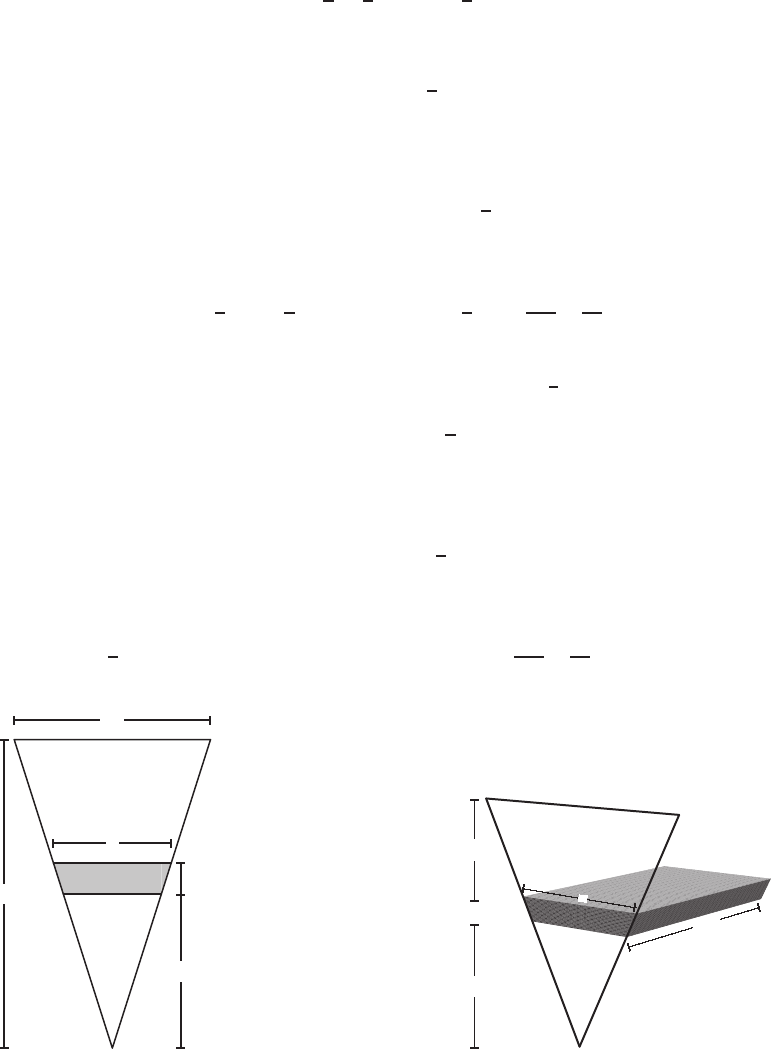
780 Chapter Eight /SOLUTIONS
26. (a) We divide the triangular end into horizontal strips of thickness ∆h. The length of a strip, s, depends on its height h
from the bottom. See Figure 8.94. We use similar triangles to see that
s
h=2
3so s=2
3h.
Since each strip is approximately a rectangle, at height h,
Area of strip ≈2
3h∆hft2.
Since the depth at height his 3−h, writing δfor the density of water, we have:
Force on one strip =δ·Depth ·Area
≈δ(3 −h)2
3h∆hlb.
To find the total force, F, we integrate the force on a strip from h= 0 to h= 3, using δ= 62.4lb/ft3:
F=Z3
0
δ(3−h)2
3hdh =2
3δZ3
0
(3h−h2)dh =2
362.43h2
2−h3
3
3
0
= 187.2lbs.
(b) To find the work, we slice the water horizontally. Each slice is a rectangular slab with thickness ∆h, length 15 ft, and
width sas in Figure 8.95. As we saw in part (a), at a height of hwe have s=2
3h. At height h,
Volume of slab ≈15 2
3h∆hft3.
The distance to lift the slice at height his 3−h, so if δis the density of water, we have:
Work to lift one slice =δ·Volume ·Distance lifted
≈δ(15( 2
3h)∆h)(3 −h)ft-lb.
To find the total work, W, we integrate the work to lift a slice from h= 0 to h= 3, using δ= 62.4lb/ft3.
W=Z3
0
δ15 2
3h(3 −h)dh= 10δZ3
0
(3h−h2)dh = 10 ·62.43h2
2−h3
3
3
0
=10δ(4.5) = 2808 ft-lbs.
✻
❄
3
ft
✲✛ 2
ft
✲✛ s
✻
❄
∆h
✻
❄
h
ft
Figure 8.94
✻
❄
h
✻
❄
∆h
✻
❄
3−h
✛
✛
s
✛
✛
15
ft
Figure 8.95
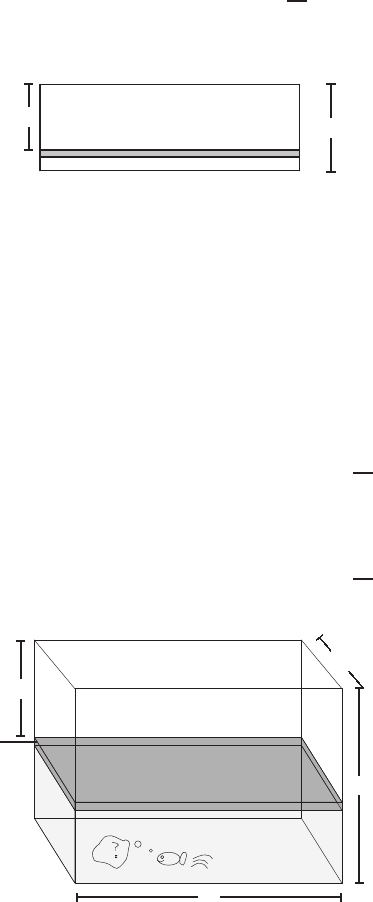
8.5 SOLUTIONS 781
27. (a) Divide the wall into horizontal strips, each of height ∆h. See Figure 8.96. The area of each strip is 1000∆h, and the
pressure at depth his 62.4h, so
Force on strip ≈1000(62.4h)∆h
Force on dam ≈X1000(62.4h)∆h.
(b) The force on the dam is given by the integral
Force on dam =Z50
0
1000(62.4h)dh = 62400 h2
2
50
0
=78,000,000 pounds.
1000
✻
❄
50
✻
❄
h
∆h
Figure 8.96
28. See Figure 8.97.
For the bottom: The bottom of the tank is at constant depth 15 feet, and therefore is under constant pressure, 15 ·
62.4 = 936 lb/ft2. The area of the base is 200 ft2, so
Total force on bottom = 200 ft2·936 lb/ft2= 187200 lb.
For the 15 ×10 side: The area of a horizontal strip of width dh is 10 dh square feet, and the pressure at height his
62.4hpounds per square foot. Therefore, the force on such a strip is 62.4h(10 dh)pounds. Hence,
Total force on the 15 ×10 side =Z15
0
(62.4h)(10) dh = 624 h2
2
15
0
= 70200 lbs.
For the 15 ×20 side: Similarly,
Total force on the 15 ×20 side =Z15
0
(62.4h)(20) dh = 1248 h2
2
15
0
= 140400 lbs.
✻
❄
h✻
❄
15
✲✛ 20
✛
✛
10
✲
∆h
Figure 8.97
29. We divide the water against the dam into horizontal strips, each of thickness ∆hand length 100.
Area of each strip ≈100∆hft2.
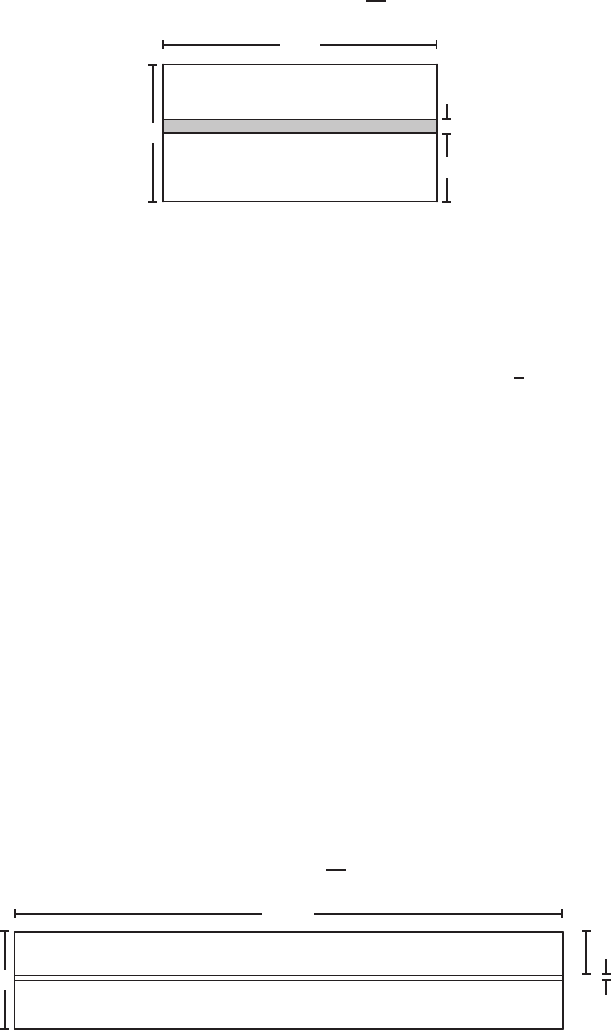
782 Chapter Eight /SOLUTIONS
See Figure 8.98. The strip at height hft from the bottom is at a water depth of 40 −h, so, if δlb/ft3is the density of water,
we have:
Force of one strip =δ·Depth ·Area
≈δ(40 −h)(100∆h)lb.
To find the total force, F, we integrate the force on a strip from h= 0 to h= 40, using δ= 62.4lb/ft3:
F=Z40
0
δ(40 −h)100dh = 100 ·62.440h−h2
2
40
0
= 6240(800) = 4,992,000lbs.
✻
❄
∆h
✻
❄
h
✻
❄
50
ft
✲✛ 100
ft
Figure 8.98
30. Bottom:
Water force = 62.4(2)(12) = 1497.6lbs.
Front and back:
Water force = (62.4)(4) Z2
0
(2−x)dx = (62.4)(4)(2x−1
2x2)
2
0
= (62.4)(4)(2) = 499.2lbs.
Both sides:
Water force = (62.4)(3) Z2
0
(2−x)dx = (62.4)(3)(2) = 374.4lbs.
31. (a) Since the density of water is δ= 1000 kg/m3, at the base of the dam, water pressure δgh = 1000 ·9.8·180 =
1.76 ·106nt/m2.
(b) To set up a definite integral giving the force, we divide the dam into horizontal strips. We use horizontal strips
because the pressure along each strip is approximately constant, since each part is at approximately the same depth.
See Figure 8.99.
Area of strip = 2000∆hm2.
Pressure at depth of hmeters =δgh = 9800hnt/m2. Thus,
Force on strip ≈Pressure ×Area = 9800h·2000∆h= 1.96 ·107h∆hnt.
Summing over all strips and letting ∆h→0gives:
Total force = lim
∆h→0X1.96·107h∆h= 1.96 ·107Z180
0
h dh newtons.
Evaluating gives
Total force = 1.96 ·107h2
2
180
0
= 3.2·1011 newtons.
✻
❄
180
m
✲✛ 2000
m
✻
❄
h
✻
❄
∆h
Figure 8.99
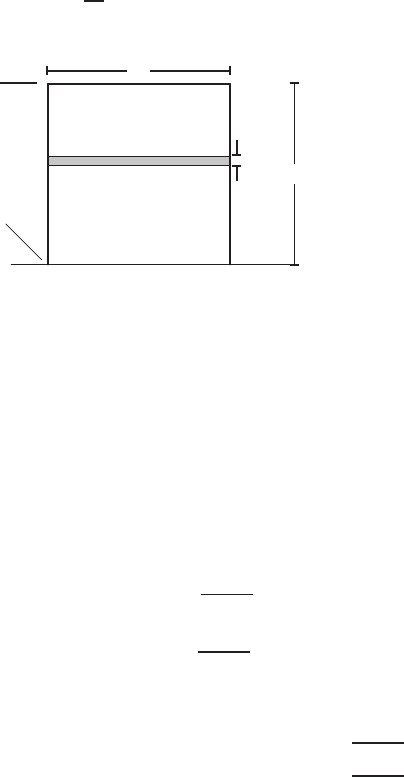
8.5 SOLUTIONS 783
32. (a) At a depth of 350 feet,
Pressure = 62.4·350 = 21,840 lb/ft2.
To imagine this pressure, we convert to pounds per square inch, giving a pressure of 21,840/144 = 151.7lb/in2.
(b) (i) When the square is held horizontally, the pressure is constant at 21,840 lbs/ft2, so
Force =Pressure ·Area = 21,840 ·52= 546,000 pounds.
(ii) When the square is held vertically, only the bottom is at 350 feet. Dividing into horizontal strips, as in Fig-
ure 8.100, we have
Area of strip = 5∆hft2.
Since the pressure on a strip at a depth of hfeet is 62.4hlb/ft2,
Force on strip ≈62.4h·5∆h= 312h∆hpounds.
Summing over all strips and taking the limit as ∆h→0gives a definite integral. The strips vary between a
depth of 350 feet and 345 feet, so
Total force = lim
∆h→0X312h∆h=Z350
345
312h dh pounds.
Evaluating gives
Total force = 312 h2
2
350
345
= 156(3502−3452) = 542,100 pounds.
❘
Depth
= 350
ft
✲
Depth
= 345
ft
✲✛ 5
ft
✻
❄
∆h
✻
❄
5
ft
Bottom of sea
Figure 8.100
33. (a) Since water has density 62.4lb/ft3, at a depth of 12,500 feet,
Pressure =Density ×Depth = 62.4·12,500 = 780,000 lb/square foot.
To imagine this pressure, observe that it is equivalent to 780,000/144 ≈5400 pounds per square inch.
(b) To calculate the pressure on the porthole (window), we slice it into horizontal strips, as the pressure remains approx-
imately constant along each one. See Figure 8.101. Since each strip is approximately rectangular
Area of strip ≈2r∆hft2.
To calculate rin terms of h, we use the Pythagorean Theorem:
r2+h2= 9
r=p9−h2,
so
Area of strip ≈2p9−h2∆hft2.
The center of the porthole is at a depth of 12,500 feet below the surface, so the strip shown in Figure 8.101 is at a
depth of (12,500 −h)feet. Thus, pressure on the strip is 62.4(12,500 −h)lb/ft2, so
Force on strip =Pressure ×Area ≈62.4(12,500 −h)2p9−h2∆hlb
= 124.8(12,500 −h)p9−h2∆hlb.

784 Chapter Eight /SOLUTIONS
To get the total force, we sum over all strips and take the limit as ∆h→0. Since hranges from −3to 3, we get the
integral
Total force = lim
∆h→0X124.8(12,500 −h)p9−h2∆h
= 124.8Z3
−3
(12,500 −h)p9−h2dh lb.
Evaluating the integral numerically, we obtain a total force of 2.2·107pounds.
3
ft
✲✛ r
✻
❄
∆h
✻
❄
h
✻
❄
6
ft
Figure 8.101
: Center of circle is 12,500 ft
below the surface of ocean
34. We divide the dam into horizontal strips since the pressure is then approximately constant on each one. See Figure 8.102.
Area of strip ≈w∆hm2.
Since wis a linear function of h, and w= 3600 when h= 0, and w= 3000 when h= 100, the function has slope
(3000 −3600)/100 = −6. Thus,
w= 3600 −6h,
so
Area of strip ≈(3600 −6h)∆hm2.
The density of water is δ= 1000 kg/m3, so the pressure at depth hmeters =δgh = 1000 ·9.8h= 9800hnt/m2. Thus,
Total force = lim
∆h→0X9800h(3600 −6h)∆h= 9800 Z100
0
h(3600 −6h)dh newtons.
Evaluating the integral gives
Total force = 9800(1800h2−2h3)
100
0
=1.6·1011 newtons.
✻
❄
100
m
✲✛ 3000
m
✲✛ 3600
m
✻
❄
∆h
✻
❄
h
w
Figure 8.102
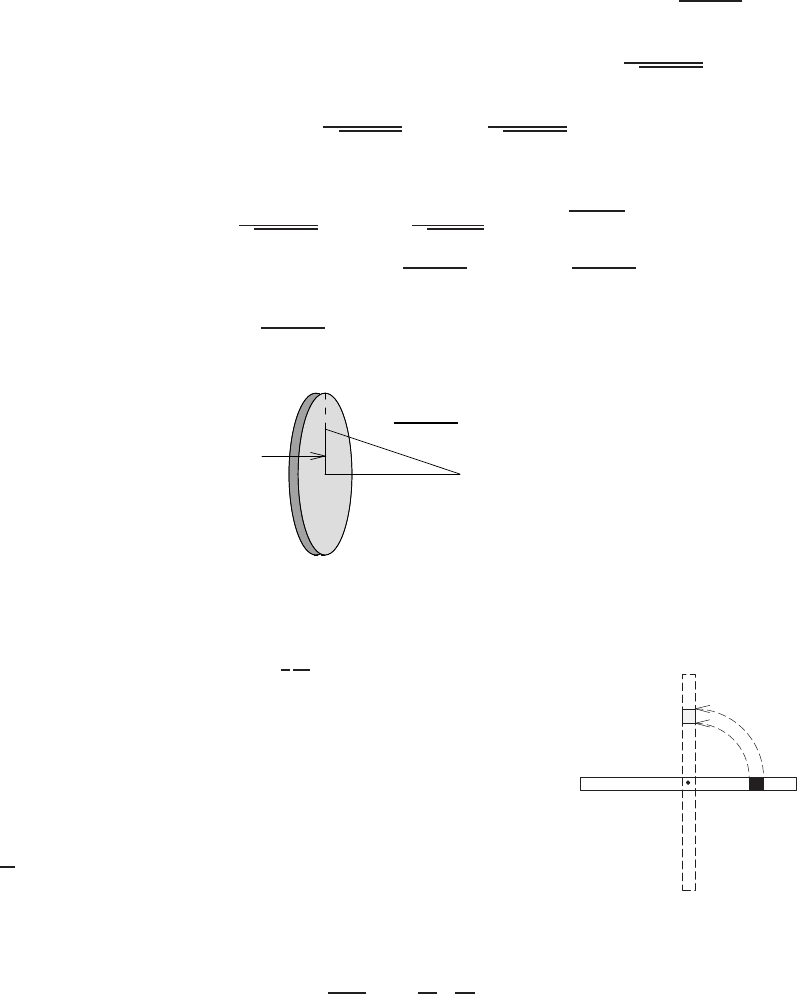
8.5 SOLUTIONS 785
35. We need to divide the disk up into circular rings of charge and integrate their contributions to the potential (at P) from 0
to a. These rings, however, are not uniformly distant from the point P. A ring of radius zis √R2+z2away from point
P(see Figure 8.103).
The ring has area 2πz ∆z, and charge 2πzσ ∆z. The potential of the ring is then 2πzσ ∆z
√R2+z2and the total potential
at point Pis Za
0
2πzσ dz
√R2+z2=πσ Za
0
2z dz
√R2+z2.
We make the substitution u=z2. Then du = 2z dz. We obtain
πσ Za
0
2zdz
√R2+z2=πσ Za2
0
du
√R2+u=πσ(2pR2+u)
a2
0
=πσ(2pR2+z2)
a
0
= 2πσ(pR2+a2−R).
(The substitution u=R2+z2or √R2+z2works also.)
zP
R
√R2+z2
Figure 8.103
36. The density of the rod is 10 kg/6 m = 5
3
kg
m. A lit-
tle piece, dx m, of the rod thus has mass 5/3dx kg.
If this piece has an angular velocity of 2 rad/sec,
then its actual velocity is 2|x|m/sec. This is be-
cause a radian angle sweeps out an arc length equal
to the radius of the circle, and in this case the lit-
tle piece moves in circles about the origin of ra-
dius |x|. See Figure 8.104. The kinetic energy of
the little piece is mv2/2 = (5/3dx)(2|x|)2/2 =
10
3x2dx.
✛
✛
x
dx
3
Figure 8.104
Therefore,
Total Kinetic Energy =Z3
−3
10x2
3dx =20
3x3
3
3
0
=60 kg ·m2/sec2= 60 joules.
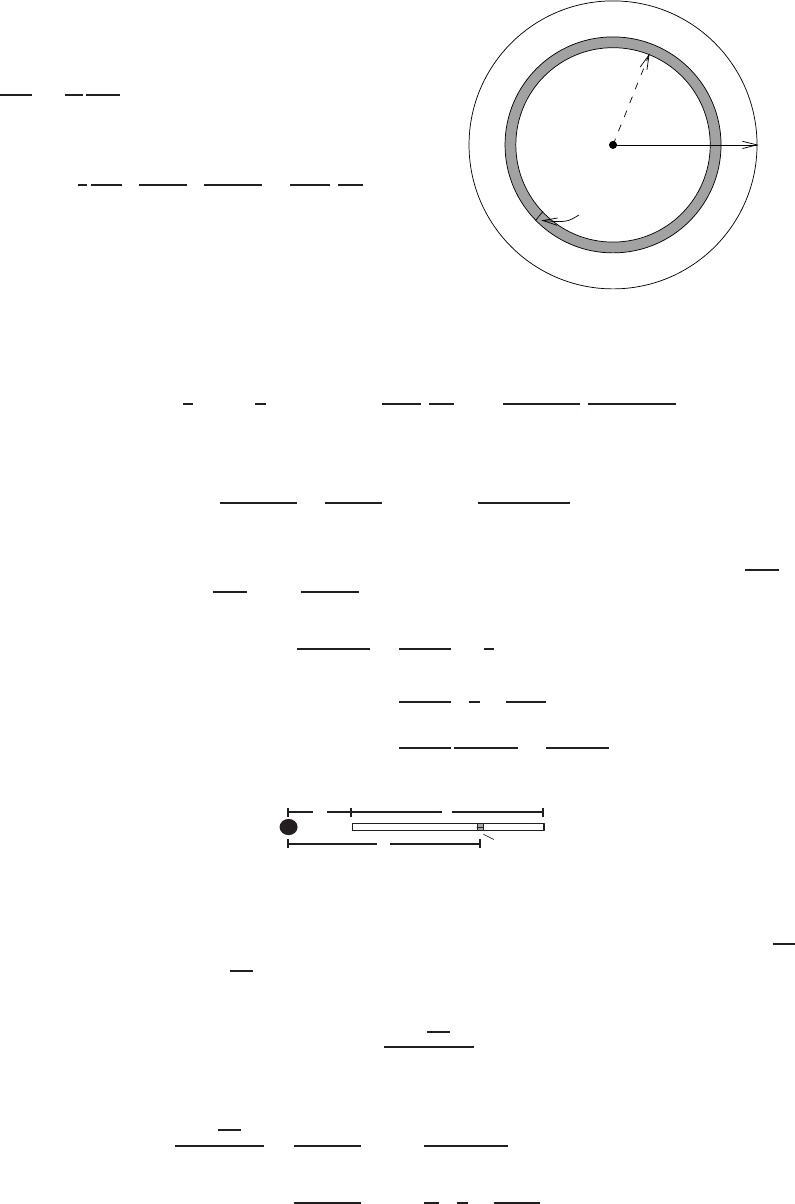
786 Chapter Eight /SOLUTIONS
37. We slice the record into rings in such a way that every point
has approximately the same speed: use concentric circles
around the hole. See Figure 8.105. We assume the record is
a flat disk of uniform density: since its mass is 50 grams and
its area is π(10cm)2= 100πcm2, the record has density
50
100π=1
2π
gram
cm2. So a ring of width dr, having area about
2πr dr cm2, has mass approximately (2πr dr)(1/2π) =
r dr gm.At radius r, the velocity of the ring is
33 1
3
rev
min ·1 min
60 sec ·2πr cm
1 rev =10πr
9
cm
sec .
r
dr
10 cm
Figure 8.105
The kinetic energy of the ring is
1
2mv2=1
2(r dr grams) 10πr
9
cm
sec 2
=50π2r3dr
81
gram ·cm2
sec2.
So the kinetic energy of the record, summing the energies of all these rings, is
Z10
0
50π2r3dr
81 =25π2r4
162
10
0≈15231 gram ·cm2
sec2= 15231 ergs.
38. The density of the rod, in mass per unit length, is M/l (see Figure 8.106). So a slice of size dr has mass M dr
l. It pulls the
small mass mwith force Gm M dr
l/r2=GmM dr
lr2. So the total gravitational attraction between the rod and point is
Za+l
a
GmM dr
lr2=GmM
l−1
r
a+l
a
=GmM
l1
a−1
a+l
=GmM
l
l
a(a+l)=GmM
a(a+l).
✲✛ a✲✛ l
✲✛ rdr
❨
Figure 8.106
39. This time, let’s split the second rod into small slices of length dr. See Figure 8.107. Each slice is of mass M2
l2dr, since
the density of the second rod is M2
l2. Since the slice is small, we can treat it as a particle at distance raway from the end
of the first rod, as in Problem 38. By that problem, the force of attraction between the first rod and particle is
GM1M2
l2dr
(r)(r+l1).
So the total force of attraction between the rods is
Za+l2
a
GM1M2
l2dr
(r)(r+l1)=GM1M2
l2Za+l2
a
dr
(r)(r+l1)
=GM1M2
l2Za+l2
a
1
l11
r−1
r+l1dr.
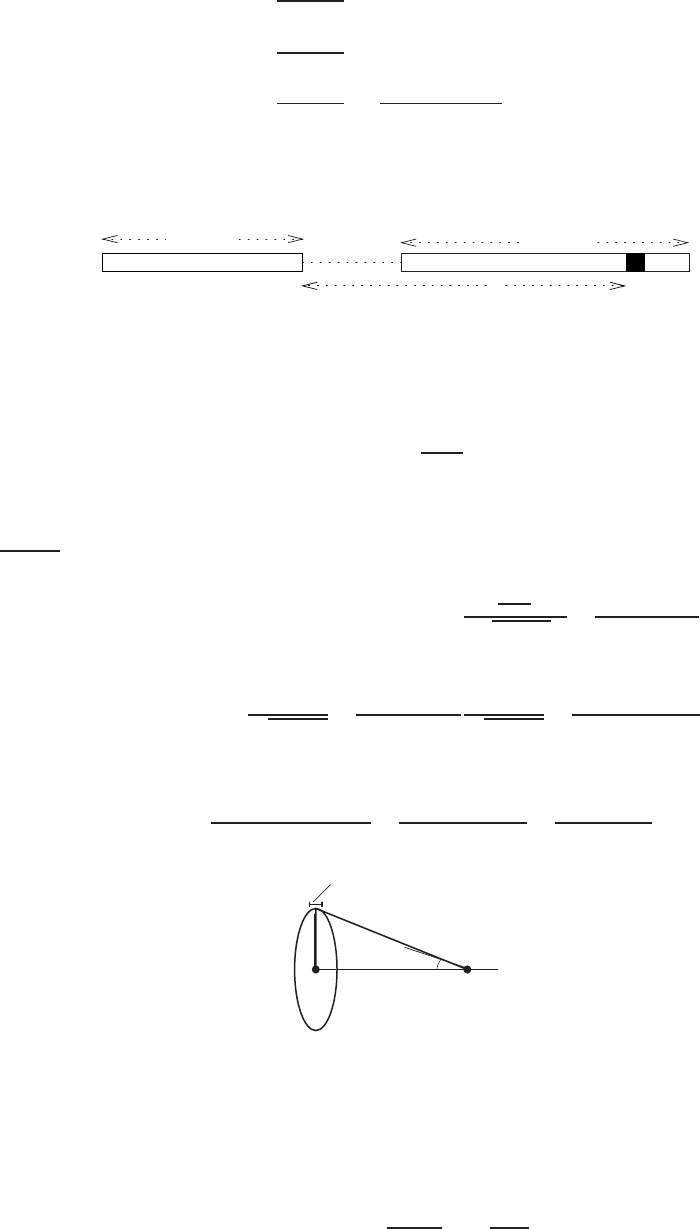
8.5 SOLUTIONS 787
=GM1M2
l1l2
(ln |r| − ln |r+l1|)
a+l2
a
=GM1M2
l1l2
[ln |a+l2| − ln |a+l1+l2| − ln |a|+ ln |a+l1|]
=GM1M2
l1l2
ln (a+l1)(a+l2)
a(a+l1+l2).
This result is symmetric: if you switch l1and l2or M1and M2, you get the same answer. That means it’s not important
which rod is “first,” and which is “second.”
l2
l1a
dr
r
Figure 8.107
40. In Figure 8.108, consider a small piece of the ring of length ∆land mass
∆M=∆lM
2πa .
The gravitational force exerted by the small piece of the ring is along the line QP. As we sum over all pieces of the
ring, the components perpendicular to the line OP cancel. The components of the force toward the point O are all in the
same direction, so the net force is in this direction. The small piece of length ∆land mass ∆lM/2πa is at a distance of
pa2+y2from P, so
Gravitational force from small piece = ∆F=G∆lM
2πa m
(pa2+y2)2=GMm∆l
2πa(a2+y2).
Thus the force toward O exerted by the small piece is given by
∆Fcos θ= ∆Fy
pa2+y2=GMm∆l
2πa(a2+y2)
y
pa2+y2=GMmy∆l
2πa(a2+y2)3/2.
The total force toward O is given by F≈P∆Fcos θ, so
F=GMmy ·Total length
2πa(a2+y2)3/2=GMmy2πa
2πa(a2+y2)3/2=GMmy
(a2+y2)3/2.
O
a
Q
∆F
P
my
θ
✠
✻✐
∆l
Figure 8.108
41. Divide the disk into rings of radius r, width ∆r, as shown in Figure 8.109.
Then
Area of ring ≈2πr∆r.
Since total area of disk is πa2,
Mass of ring ≈2πr∆r
πa2M=2rM
a2∆r.
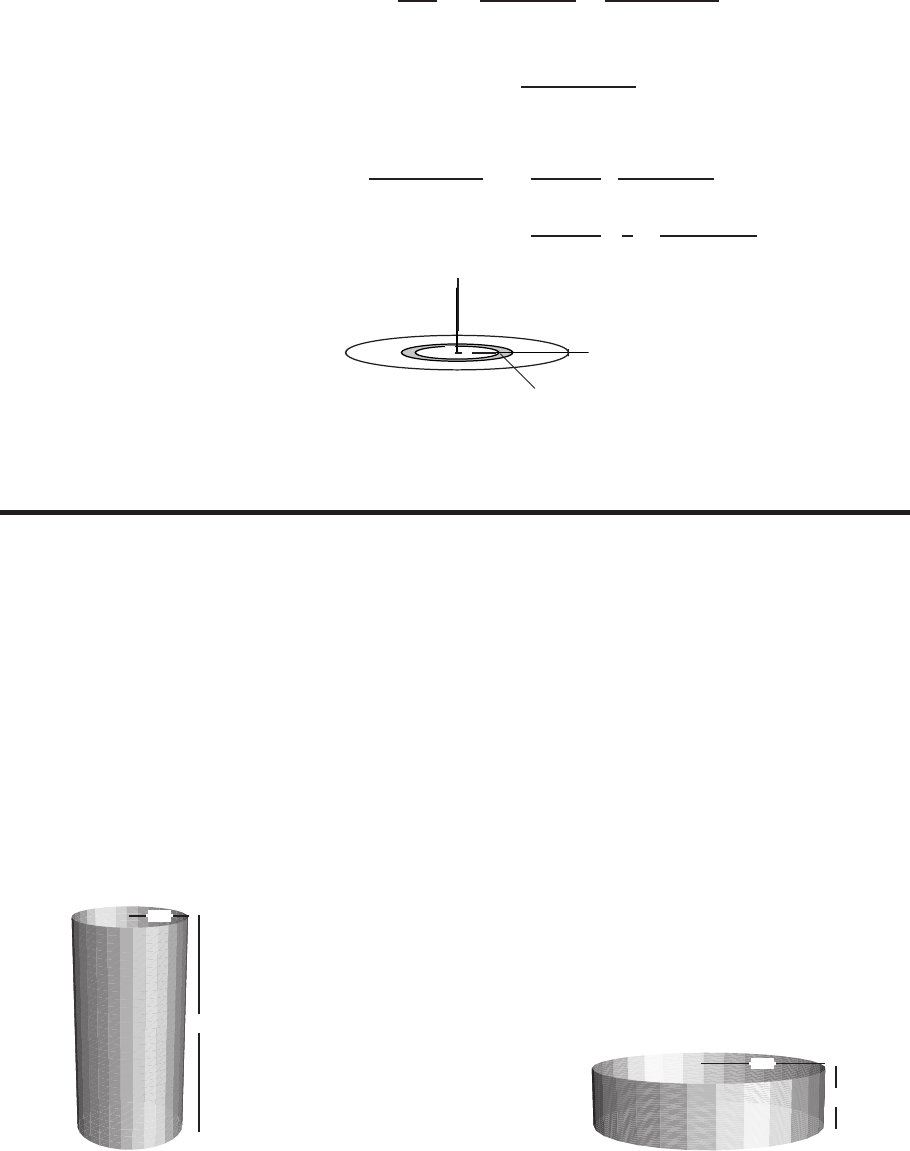
788 Chapter Eight /SOLUTIONS
Thus, calculating the gravitational force due to the ring, we have
Gravitational force
on mdue to ring =G2rM
a2∆rmy
(r2+y2)3/2=2GMmyr
a2(r2+y2)3/2∆r.
Summing over all rings, we get
Total gravitational force
on mdue to disk ≈X2GMmyr
a2(r2+y2)3/2∆r.
As ∆r→0, we get
Gravitational force
on mdue to disk =Za
0
2GMmyr
a2(r2+y2)3/2dr =2GMmy
a2·−1
(r2+y2)1/2
a
0
=2GMmy
a21
y−1
(a2+y2)1/2.
✲
✻
r■
O
y
P
a
∆r
Figure 8.109
Strengthen Your Understanding
42. The calculation given is correct when the entire rope is lifted 20 m. But the portions of the rope nearer the top are raised
a shorter distance, so less work is required.
43. It takes less work to pump the oil out of the top half of the tank than to pump it out of the bottom half of the tank because
the oil in the top half has to be lifted a shorter distance. Emptying the full tank takes less than twice as much work as
emptying the half-filled tank.
44. The force exerted lifting the rock is equal to 10 kg ×9.8m/sec2= 98 nt. The work is
Work =Force ×Distance = 98 ·2joules.
45. Raising a 2 kg book 1 meter off the ground requires work Force ×Distance where Force = (2 kg)9.8m/sec2and
Distance = 1 meter .
46. Let tank Abe a cylinder of radius 1 meter and height 4 meters and tank Bbe a cylinder of radius 2 meters and height
1 meter as shown in Figure 8.110. The volume of each tank is 4π= 12.56 meters3.All the water in tank Bhas to be
pumped at least 9 meters, whereas the water in the top part of tank Ahas to be pumped a shorter distance. Therefore, it
takes less work to pump the water from tank Ato a height of 10 meters than the water from tank B.
✲✛1
m
✻
❄
4
m
Tank
A
✲✛ 2
m
✻
❄
1
m
Tank
B
Figure 8.110
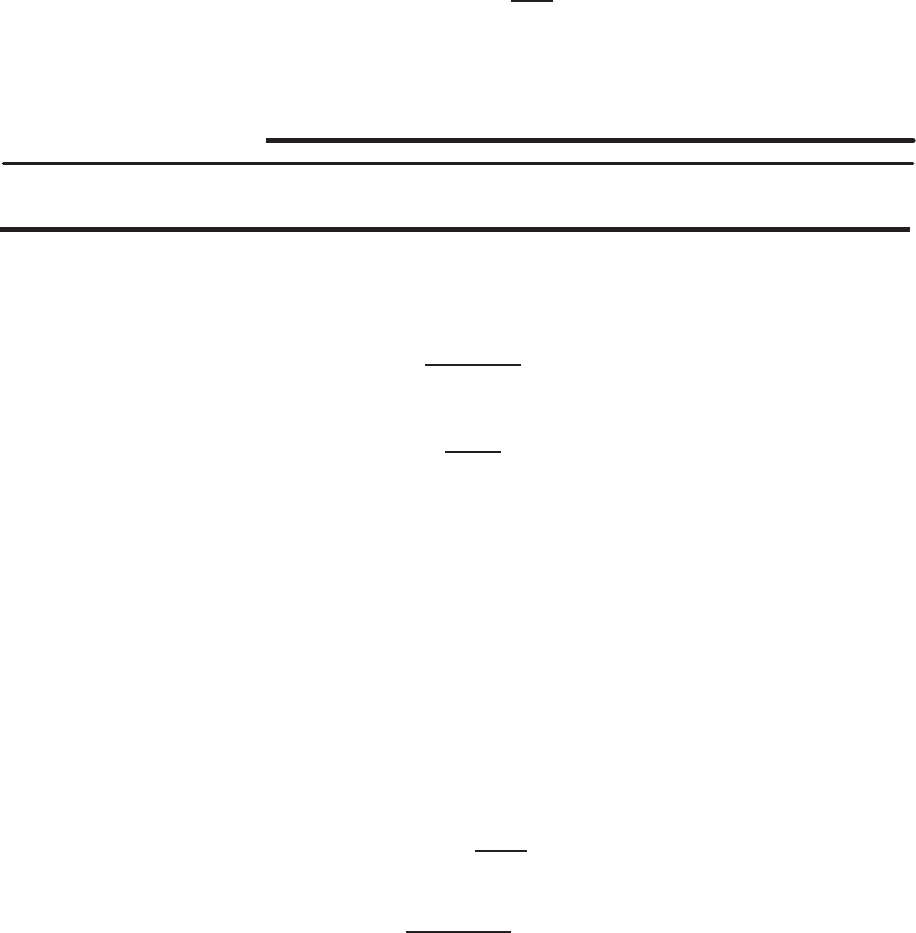
8.6 SOLUTIONS 789
47. False. Work is the product of force and distance moved, so the work done in either case is 200 ft-lb.
48. True. Displacement in the same direction as the force gives positive work; displacement in the opposite direction as the
force gives negative work.
49. False. Since the water pressure increases with depth, the force on the lower half of the new dam is greater than the force
on the upper half of the new dam, which is the same as the force on the old dam. Thus the force on the new dam is more
than double the force on the old dam.
50. True. Since pressure increases with depth and we want the pressure to be approximately constant on each strip, we use
horizontal strips.
51. False. The pressure is positive and when integrated gives a positive force.
52. True. Although work is expressed in an integral, the average value is also expressed in an integral. We have:
Average value of the force =1
4−1Z4
1
F(x)dx.
Thus if we multiply the average force by 3, we get R4
1F(x)dx, which is the work done.
Solutions for Section 8.6
Exercises
1. The future value, in dollars, is
C(1 + 0.03)25.
2. The present value, in dollars, is
C
(1 + 0.03)25 .
3. The present value, in dollars, is
C
e0.03(5) .
4. The present value, in dollars, is Z15
0
C e−0.02tdt.
5. The future value, in dollars, is Z15
0
Ce0.02(15−t)dt.
6. The future value, in dollars, is
500e0.02(C)+ 500e0.02(C−1) + 500e0.02(C−2).
7. We want
Cer·30 = 25,000.
Thus,
e30r=25,000
C,
so, taking logs, we find the continuous interest rate is
r=ln(25,000/C)
30 per year.

790 Chapter Eight /SOLUTIONS
8. At any time t, in a time interval ∆t, an amount of 1000∆tis deposited into the account. This amount earns interest for
(10 −t)years giving a future value of 1000e(0.08)(10−t). Summing all such deposits, we have
Future value =Z10
0
1000e0.08(10−t)dt = $15,319.30.
9. (a)
Future Value =Z20
0
100e0.10(20−t)dt
= 100 Z20
0
e2e−0.10tdt
=100e2
−0.10 e−0.10t
20
0
=100e2
0.10 (1 −e−0.10(20) )≈$6389.06.
The present value of the income stream is
Z20
0
100e−0.10tdt = 100 1
−0.10 e−0.10t
20
0
= 1000 1−e−2= $864.66.
Note that this is also the present value of the sum $6389.06.
(b) Let Tbe the number of years for the balance to reach $5000. Then
5000 = ZT
0
100e0.10(T−t)dt
50 = e0.10TZT
0
e−0.10tdt
=e0.10T
−0.10 e−0.10t
T
0
=10e0.10T(1 −e−0.10T) = 10e0.10T−10.
So, 60 = 10e0.10T, and T= 10 ln 6 ≈17.92 years.
10. We compute the future value first: we have
Future value =Z5
0
2000e0.08(5−t)dt = $12,295.62.
We can compute the present value using an integral and the income stream or using the future value. We compute the
present value, P, from the future value:
12295.62 = P e0.08(5) so P= 8242.00.
The future value of this income stream is $12,295.62 and the present value of this income stream is $8,242.00.
11. (a) We compute the future value of this income stream:
Future value =Z20
0
1000e0.07(20−t)dt = $43,645.71.
After 20 years, the account will contain $43,645.71.
(b) The person has deposited $1000 every year for 20 years, for a total of $20,000.
(c) The total interest earned is $43,645.71 −$20,000 = $23,645.71.
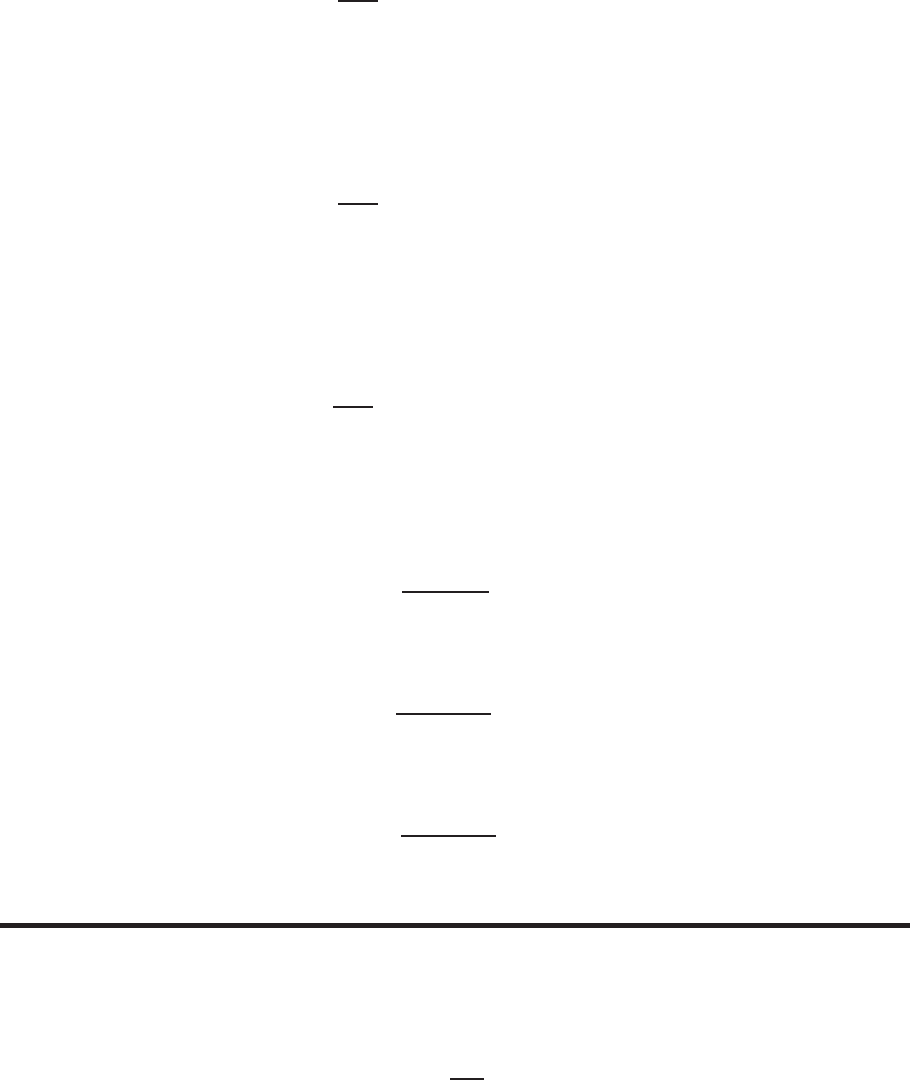
8.6 SOLUTIONS 791
12. Since we want to have $20,000 in 60 years starting with a single initial deposit of $10,000, we have
20,000 = 10,000 er(60).
Solving for r, we get:
2 = er(60)
r=ln(2)
60
r= 0.01155 or r= 1.155% per year.
13. Since we want to have $20,000 in 15 years starting with a single initial investment of $10,000, we have
20,000 = 10,000er(15) .
Solving for r, we get:
2 = er(15)
r=ln(2)
15
r= 0.04621 or r= 4.621% per year.
14. Since we want to have $20,000 in 5years starting with a single initial deposit of $10,000, we have
20,000 = 10,000er(5) .
Solving for r, we get:
2 = er(5)
r=ln(2)
5
r= 0.13863 or r= 13.863% per year.
Notice that the goal of doubling the initial $10,000 deposit in a short period of time (5 years) leads to a high interest rate
(13.863%).
15. A constant income stream that pays 20,000 in 5years has a yearly rate amount of 20,000/5 = 4000 dollars/year. Thus,
the future value, B, of the stream at the end of 5years is
B=Z5
0
4000 e0.02(5−t)dt = 4000 −e0.02(5−t)
0.02
5
0
=200,000(e0.1−1) = 21,034.18 dollars.
16. A constant income stream that pays 20,000 in 10 years has a yearly rate amount of 20,000/10 = 2000 dollars/year. Thus,
the future value, B, of the stream at the end of 10 years is
B=Z10
0
2000 e0.02(10−t)dt = 2000 −e0.02(10−t)
0.02
10
0
= 100,000(e0.2−1) = 22,140.28 dollars.
17. A constant income stream that pays 20,000 in 20 years has a yearly rate amount of 20,000/20 = 1000 dollars/year. Thus,
the future value, B, of the stream at the end of 20 years is
B=Z20
0
1000 e0.02(20−t)dt = 1000 −e0.02(20−t)
0.02
20
0
= 50,000(e0.4−1) = 24,591.23 dollars.
Problems
18. If S(t) = Sis the constant income stream, then we want
Future value = 20000 = Z10
0
Se0.03(10−t)dt =SZ10
0
e0.03(10−t)dt.
Evaluating the integral gives Z10
0
e0.03(10−t)dt =−1
0.03 e0.03(10−t)
10
0
= 11.662.
Then S= 20000/11.662 = 1714.97 dollars per year.

792 Chapter Eight /SOLUTIONS
19.
1 2 t
(years from present)
$
/year
The graph reaches a peak each summer, and a trough each winter. The graph shows sunscreen sales increasing from
cycle to cycle. This gradual increase may be due in part to inflation and to population growth.
20. (a) The lump sum payment has a present value of 120 million dollars . We compute the present value of the other option
at 6% and 3%. An award of $195 million paid out continuously over 20 years works out to an income stream of 9.75
million dollars per year.
If the interest rate is 6%, compounded continuously, we have
Present value at 6% =Z20
0
9.75e−0.06tdt =9.75
−0.06 (e−0.06·20 −1) = 113.556 million dollars.
Since this amount is less than the lump sum payment of 120 million dollars, the lump sum payment is preferable if
the interest rate is 6%.
If the interest rate is 3%, we have
Present value at 3% =Z20
0
9.75e−0.03tdt =9.75
−0.03 (e−0.03·20 −1) = 146.636 million dollars.
Since this amount is greater than the lump sum payment of 120 million dollars, taking payments continuously over
20 years is the better option if the interest rate is 3%.
(b) The assumption is that the interest rates would stay relatively high (closer to 6%). The interest rate at which the
decision changes is the solution to the equation
9.75
−x(e−20x−1) = 120.
Using a graph or numerical methods gives x= 5.3%. Thus if Mr. Nabors chooses the lump sum, he is assuming
interests rates stay above 5.3%.
21. (a) Solve for P(t) = P.
100000 = Z10
0
P e0.10(10−t)dt =P e Z10
0
e−0.10tdt
=P e
−0.10 e−0.10t
10
0
=P e(−3.678 + 10)
=P·17.183.
So, P≈$5820 per year.
(b) To answer this, we’ll calculate the present value of $100,000:
100000 = P e0.10(10)
P≈$36,787.94.
22. (a) Let Lbe the number of years for the balance to reach $10,000. Since our income stream is $1000 per year, the future
value of this income stream should equal (in Lyears) $10,000. Thus
10000 = ZL
0
1000e0.05(L−t)dt = 1000e0.05LZL
0
e−0.05tdt
= 1000e0.05L−1
0.05 e−0.05t
L
0
= 20000e0.05L1−e−0.05L
= 20000e0.05L−20000
so e0.05L=3
2
L= 20 ln 3
2≈8.11 years.
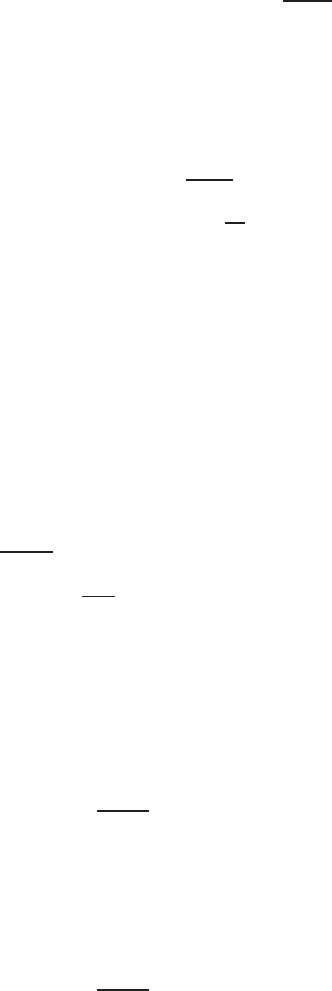
8.6 SOLUTIONS 793
(b) We want
10000 = 2000e0.05L+ZL
0
1000e0.05(L−t)dt.
The first term on the right hand side is the future value of our initial balance. The second term is the future value of
our income stream. We want this sum to equal $10,000 in Lyears. We solve for L:
10000 = 2000e0.05L+ 1000e0.05LZL
0
e−0.05tdt
= 2000e0.05L+ 1000e0.05L1
−0.05 e−0.05t
L
0
=2000e0.05L+ 20000e0.05L1−e−0.05L
= 2000e0.05L+ 20000e0.05L−20000.
So,
22000e0.05L= 30000
e0.05L=30000
22000
L= 20 ln 15
11 ≈6.203 years.
23. You should choose the payment which gives you the highest present value. The immediate lump-sum payment of $2800
obviously has a present value of exactly $2800, since you are getting it now. We can calculate the present value of the
installment plan as:
PV = 1000e−0.06(0) + 1000e−0.06(1) + 1000e−0.06(2)
≈$2828.68.
Since the installment payments offer a (slightly) higher present value, you should accept this option.
24. The initial $9000 deposit earns interest for 20 years. Since we want to have $18,000 in 20 years, we have:
18,000 = 9000er(20).
Solving for r, we get:
18,000
9000 =er(20)
r=ln 2
20
r= 0.03466 or r= 3.466% per year.
25. The initial $6000 deposit earns interest for 20 years. The second deposit only earns interest for 17 years. Since we want
to have $18,000 in 20 years, we have:
18,000 = 6000er(20) + 3000er(17),
or 18,000
3000 = 2er(20) +er(17).
We can solve for rnumerically or by graphing the functions on the left- and right-hand sides of the equation, and finding
the intersection point. This yields r= 0.03641, or r= 3.641% per year.
26. The initial $3000 deposit earns interest for 20 years. The second deposit earns interest for 17 years. Since we want to have
$18,000 in 20 years, we have:
18,000 = 3000er(20) + 6000er(17),
or 18,000
3000 =er(20) + 2er(17).
We can solve for rnumerically or by graphing the functions on the left- and right-hand sides of the equation, and finding
the intersection point. This yields r= 0.03843, or r= 3.843% per year.

794 Chapter Eight /SOLUTIONS
27. We want to reach a target of $18,000 in 20 years, so we have:
18,000 = Z20
0
300 er(20−t)dt.
In order to solve for r, we integrate, then solve the resulting equation graphically or numerically. We have:
18,000
300 =−er(20−t)
r
20
0
60 = e20r−1
r.
We can solve for rby graphing the functions on the left- and right-hand sides of the last equation, and finding the
intersection point. This yields r= 0.09519, or r= 9.519% per year.
28. Since we want the future value of the income stream of 4800 per year to be 100,000 in 15 years, we have
100,000 = Z15
0
4800er(15−t)dt.
Evaluating the integral gives
100,000 = 4800
−rer(15−t)
15
0
=4800
−r(e0−e15r) = 4800
r(e15r−1).
This equation is not solvable by algebraic means. However, using a computer or calculator to solve for rnumerically or
graphically we obtain r= 0.0416. So a continuous interest rate of 4.16% per year is required.
29. (a) We calculate the future values of the two options:
FV1= 6e0.1(3) + 2e0.1(2) + 2e0.1(1) + 2e0.1(0)
≈8.099 + 2.443 + 2.210 + 2
= $14.752 million.
FV2=e0.1(3) + 2e0.1(2) + 4e0.1(1) + 6e0.1(0)
≈1.350 + 2.443 + 4.421 + 6
= $14.214 million.
As we can see, the first option gives a higher future value, so he should choose Option 1.
(b) From the future value we can easily derive the present value using the formula PV =FVe−rt. So the present value is
Option 1: PV = 14.752e0.1(−3) ≈$10.929 million.
Option 2: PV = 14.214e0.1(−3) ≈$10.530 million.
30. At any time t, the company receives income of s(t)per year. It will then invest this money for a length of 2−tyears
at 6% interest, giving it future value of s(t)e(0.06)(2−t)from this income. If we sum all such incomes over the two-year
period, we can find the total value of the sales:
Value =Z2
0
s(t)e(0.06)(2−t)dt =Z2
050e−te(0.06)(2−t)dt
=Z2
050e0.12−1.06tdt =−53.1838
e1.06t
2
0
= $46,800.
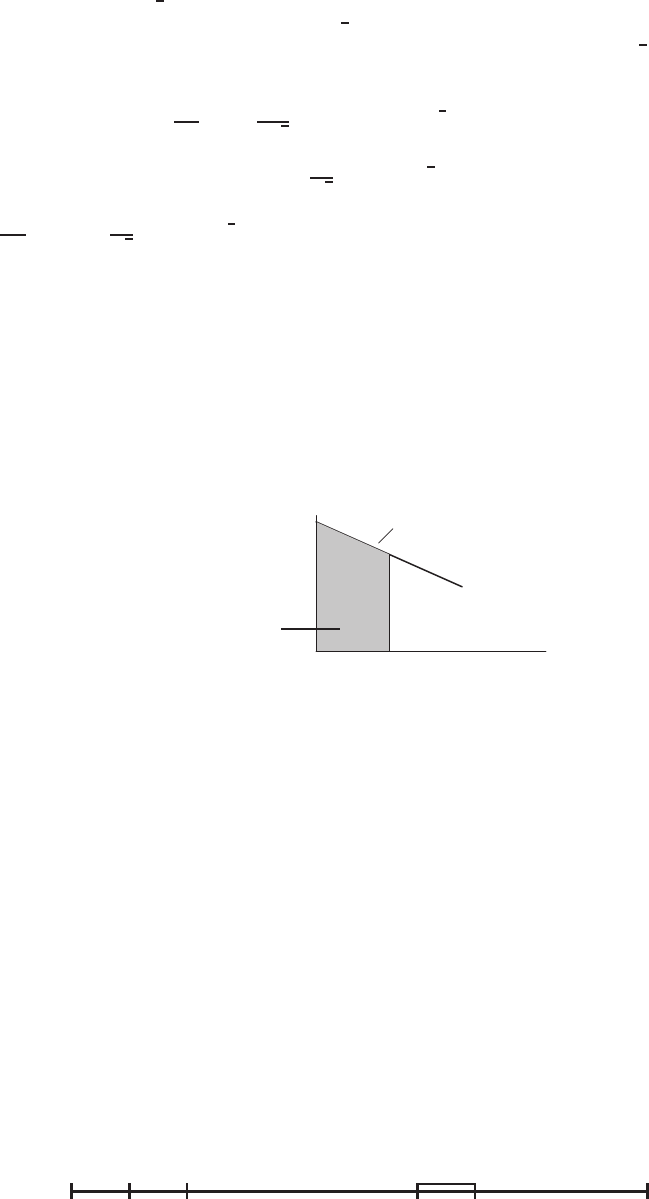
8.6 SOLUTIONS 795
31. Price in future =P(1 + 20√t).
The present value Vof price satisfies V=P(1 + 20√t)e−0.05t.
We want to maximize V. To do so, we find the critical points of V(t)for t≥0. (Recall that √tis nondifferentiable at
t= 0.)
dV
dt =P20
2√te−0.05t+ (1 + 20√t)(−0.05e−0.05t)
=P e−0.05t10
√t−0.05 −√t.
Setting dV
dt = 0 gives 10
√t−0.05 −√t= 0.Using a calculator, we find t≈10 years. Since V′(t)>0for 0< t < 10
and V′(t)<0for t > 10, we confirm that this is a maximum. Thus, the best time to sell the wine is in 10 years.
32. (a) Suppose the oil extracted over the time period [0, M]is S. (See Figure 8.111.) Since q(t)is the rate of oil extraction,
we have:
S=ZM
0
q(t)dt =ZM
0
(a−bt)dt =ZM
0
(10 −0.1t)dt.
To calculate the time at which the oil is exhausted, set S= 100 and try different values of M. We find M= 10.6
gives Z10.6
0
(10 −0.1t)dt = 100,
so the oil is exhausted in 10.6 years.
0M
t
q(t)
✠
Extraction Curve
Area below
the extraction curve
is the total oil extracted
✲
Figure 8.111
(b) Suppose pis the oil price, Cis the extraction cost per barrel, and ris the interest rate. We have the present value of
the profit as
Present value of profit =ZM
0
(p−C)q(t)e−rtdt
=Z10.6
0
(20 −10)(10 −0.1t)e−0.1tdt
= 624.9million dollars.
33. (a) Let’s split the time interval into nparts, each of length ∆t. During the interval from tito ti+1,profit is earned at
a rate of approximately (2 −0.1ti)thousand dollars per year, or (2000 −100ti)dollars per year. Thus during this
period, a total profit of (2000−100ti)∆tdollars is earned. Since this profit is earned tiyears in the future, its present
value is (2000 −100ti)∆te−0.1tidollars. Thus
Total present value ≈
n−1
X
i=0
(2000 −100ti)e−0.1ti∆t.
t0t1t2. . . titi+1 . . . tn
✛ ✲
∆t0M

796 Chapter Eight /SOLUTIONS
(b) The Riemann sum corresponds to the integral:
Present value =ZM
0
e−0.10t(2000 −100t)dt.
(c) To find where the present value is maximized, we take the derivative of
P(M) = ZM
0
e−0.10t(2000 −100t)dt,
with respect to M, and obtain
P′(M) = e−0.10M(2000 −100M).
This is 0 when 2000 −100M= 0, that is, when M= 20 years. The value M= 20 maximizes P(M), since
P′(M)>0for M < 20, and P′(M)<0for M > 20. To determine what the maximum is, we evaluate the integral
representation for P(20) by III-14 in the integral table:
P(20) = Z20
0
e−0.10t(2000 −100t)dt
=(2000 −100t)
−0.10 e−0.10t+ 10000e−0.10t
20
0≈$11353.35.
34. One good way to approach the problem is in terms of present values. In 1980, the present value of Germany’s loan was
20 billion DM. Now let’s figure out the rate that the Soviet Union would have to give money to Germany to pay off 10%
interest on the loan by using the formula for the present value of a continuous stream. Since the Soviet Union sends gas
at a constant rate, the rate of deposit, P(t), is a constant c. Since they don’t start sending the gas until after 5 years have
passed, the present value of the loan is given by:
Present Value =Z∞
5
P(t)e−rtdt.
We want to find cso that
20,000,000,000 = Z∞
5
ce−rt dt =cZ∞
5
e−rt dt
=clim
b→∞(−10e−0.10t)
b
5
=ce−0.10(5)
≈6.065c.
Dividing, we see that cshould be about 3.3 billion DM per year. At 0.10 DM per m3of natural gas, the Soviet Union
must deliver gas at the constant, continuous rate of about 33 billion m3per year.
35. Measuring money in thousands of dollars, the equation of the line representing the demand curve passes through (50, 980)
and (350, 560). Its slope is (560 −980)/(350 −50) = −420/300. See Figure 8.112. So the equation is y−560 =
−420
300 (x−350), i.e. y−560 = −7
5x+ 490.Thus
Consumer surplus =Z350
0−7
5x+ 1050dx −350 ·560 = −7
10 x2+ 1050x
350
0−196000
= 85,750.
(Note that 85,750 = 1
2·490 ·350,the area of the triangle in Figure 8.112. We could have used this instead of the integral
to find the consumer surplus.)
Recalling that our unit measure for the price axis is $1000/car, the consumer surplus is $85,750,000.

8.6 SOLUTIONS 797
1050 (50,980)
(350,560)
Demand
price
(1000s of dollars/car)
quantity
(number of cars)
Figure 8.112
36. The supply curve, S(q),represents the minimum price pper unit that the suppliers will be willing to supply some quantity
qof the good for. See Figure 8.113. If the suppliers have q∗of the good and q∗is divided into subintervals of size ∆q,
then if the consumers could offer the suppliers for each ∆qa price increase just sufficient to induce the suppliers to sell
an additional ∆qof the good, the consumers’ total expenditure on q∗goods would be
p1∆q+p2∆q+···=Xpi∆q.
As ∆q→0the Riemann sum becomes the integral Zq∗
0
S(q)dq. Thus Zq∗
0
S(q)dq is the amount the consumers would
pay if suppliers could be forced to sell at the lowest price they would be willing to accept.
q∗
P1
P2
S(q)
∆q∆q∆q
Quantity
Price
Figure 8.113
37.
Zq∗
0
(p∗−S(q))dq =Zq∗
0
p∗dq −Zq∗
0
S(q)dq
=p∗q∗−Zq∗
0
S(q)dq.
Using Problem 36, this integral is the extra amount consumers pay (i.e., suppliers earn over and above the minimum they
would be willing to accept for supplying the good). It results from charging the equilibrium price.
38. (a) p∗q∗=the total amount paid for q∗of the good at equilibrium. See Figure 8.114.
(b) Rq∗
0D(q)dq=the maximum consumers would be willing to pay if they had to pay the highest price acceptable to
them for each additional unit of the good. See Figure 8.115.
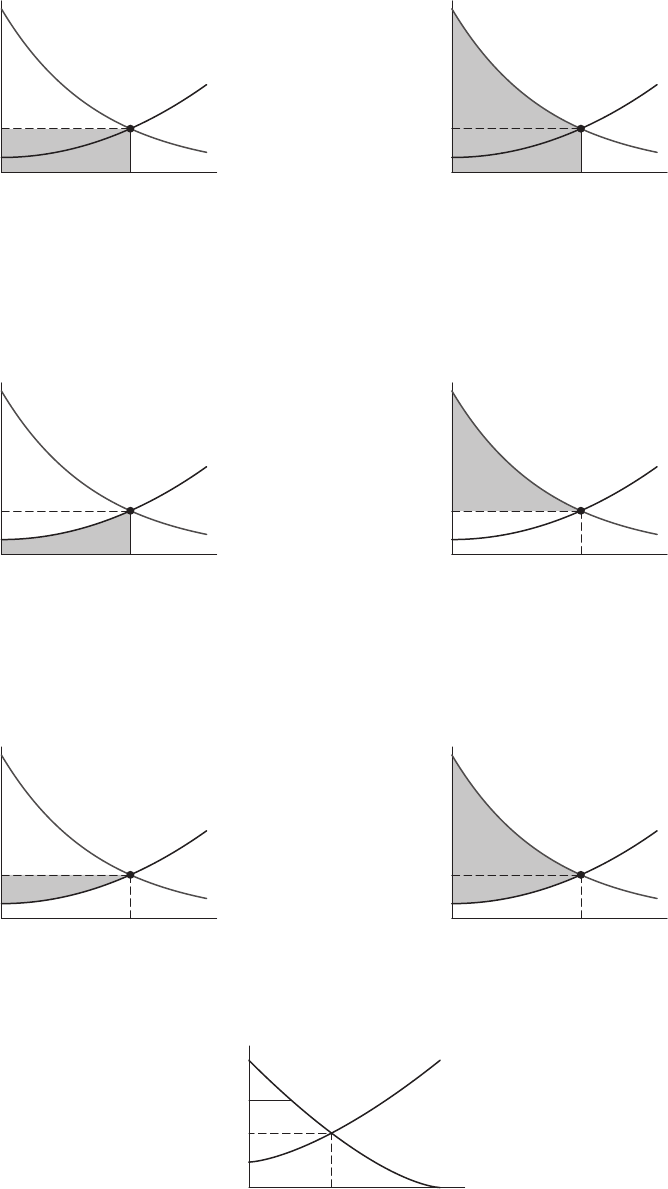
798 Chapter Eight /SOLUTIONS
q∗
p∗
quantity
price
Supply
:S(q)
Demand
:D(q)
Figure 8.114
q∗
p∗
quantity
price
Supply
:S(q)
Demand
:D(q)
Figure 8.115
(c) Rq∗
0S(q)dq =the minimum suppliers would be willing to accept if they were paid the minimum price acceptable to
them for each additional unit of the good. See Figure 8.116.
(d) Rq∗
0D(q)dq−p∗q∗=consumer surplus. See Figure 8.117.
q∗
p∗
quantity
price
Supply
:S(q)
Demand
:D(q)
Figure 8.116
q∗
p∗
quantity
price
Supply
:S(q)
Demand
:D(q)
Figure 8.117
(e) p∗q∗−Rq∗
0S(q)dq =producer surplus. See Figure 8.118.
(f) Rq∗
0(D(q)−S(q)) dq =producer surplus and consumer surplus. See Figure 8.119.
q∗
p∗
quantity
price
Supply
:S(q)
Demand
:D(q)
Figure 8.118
q∗
p∗
quantity
price
Supply
:S(q)
Demand
:D(q)
Figure 8.119
39.
q∗
p∗
p+
q
(quantity)
p
(price/unit)
Figure 8.120
: What effect does the artificially high price, p+, have?
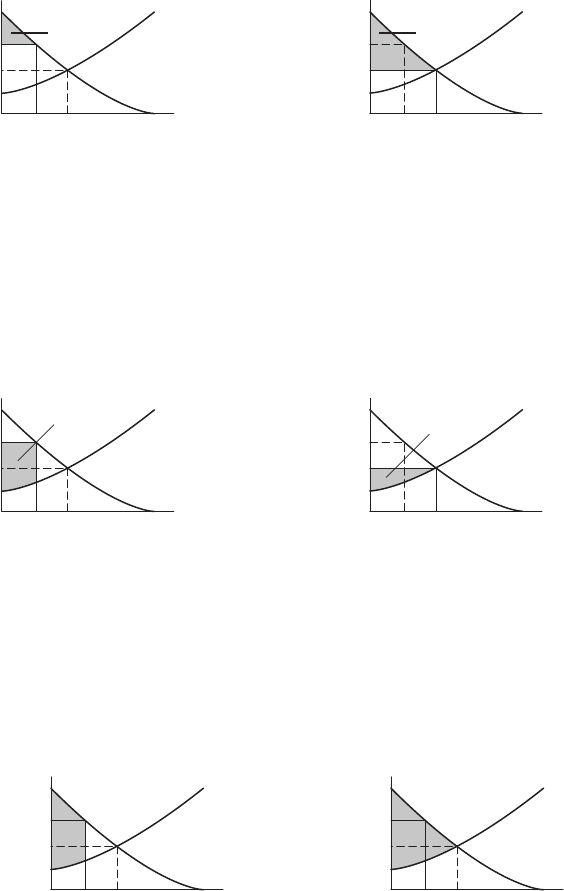
8.6 SOLUTIONS 799
(a) A graph of possible demand and supply curves for the milk industry is given in Figure 8.120, with the equilibrium
price and quantity labeled p∗and q∗respectively. Suppose that the price is fixed at the artificially high price labeled
p+in Figure 8.120. Recall that the consumer surplus is the difference between the amount the consumers did pay
(p+) and the amount they would have been willing to pay (given on the demand curve). This is the area shaded in
Figure 8.121(i). Notice that this consumer surplus is clearly less than the consumer surplus at the equilibrium price,
shown in Figure 8.121(ii).
Artificial price
q∗
p∗
p+
q+
✛
consumer
surplus
q
(quantity)
p
(price/unit)
(i)
q∗
q+
Equilibrium price
p∗
p+✛
consumer
surplus
q
(quantity)
p
(price/unit)
(ii)
Figure 8.121
: Consumer surplus for the milk industry
(b) At a price of p+, the quantity sold, q+, is less than it would have been at the equilibrium price. The producer surplus
is the area between p+and the supply curve at this reduced demand. This area is shaded in Figure 8.122(i). Compare
this producer surplus (at the artificially high price) to the producer surplus in Figure 8.122(ii) (at the equilibrium
price). It appears that in this case, producer surplus is greater at the artificial price than at the equilibrium price.
(Different supply and demand curves might have led to a different answer.)
Artificial price
q∗
p∗
p+
q+
✠
producer
surplus
q
(quantity)
p
(price/unit)
(i) Equilibrium price
q∗
q+
p∗
p+
✠
producer
surplus
q
(quantity)
p
(price/unit)
(ii)
Figure 8.122
: Producer surplus for the milk industry
(c) The total gains from trade (Consumer surplus +Producer surplus) at the artificially high price of p+is the area shaded
in Figure 8.123(i). The total gains from trade at the equilibrium price of p∗is the area shaded in Figure 8.123(ii). It is
clear that, under artificial price conditions, total gains from trade go down. The total financial effect of the artificially
high price on all producers and consumers combined is a negative one.
q∗
p∗
p+
q+q
(quantity)
p
(price/unit)
Artificial price(i)
q∗
p∗
p+
q+q
(quantity)
p
(price/unit)
Equilibrium price
(ii)
Figure 8.123
: Total gains from trade
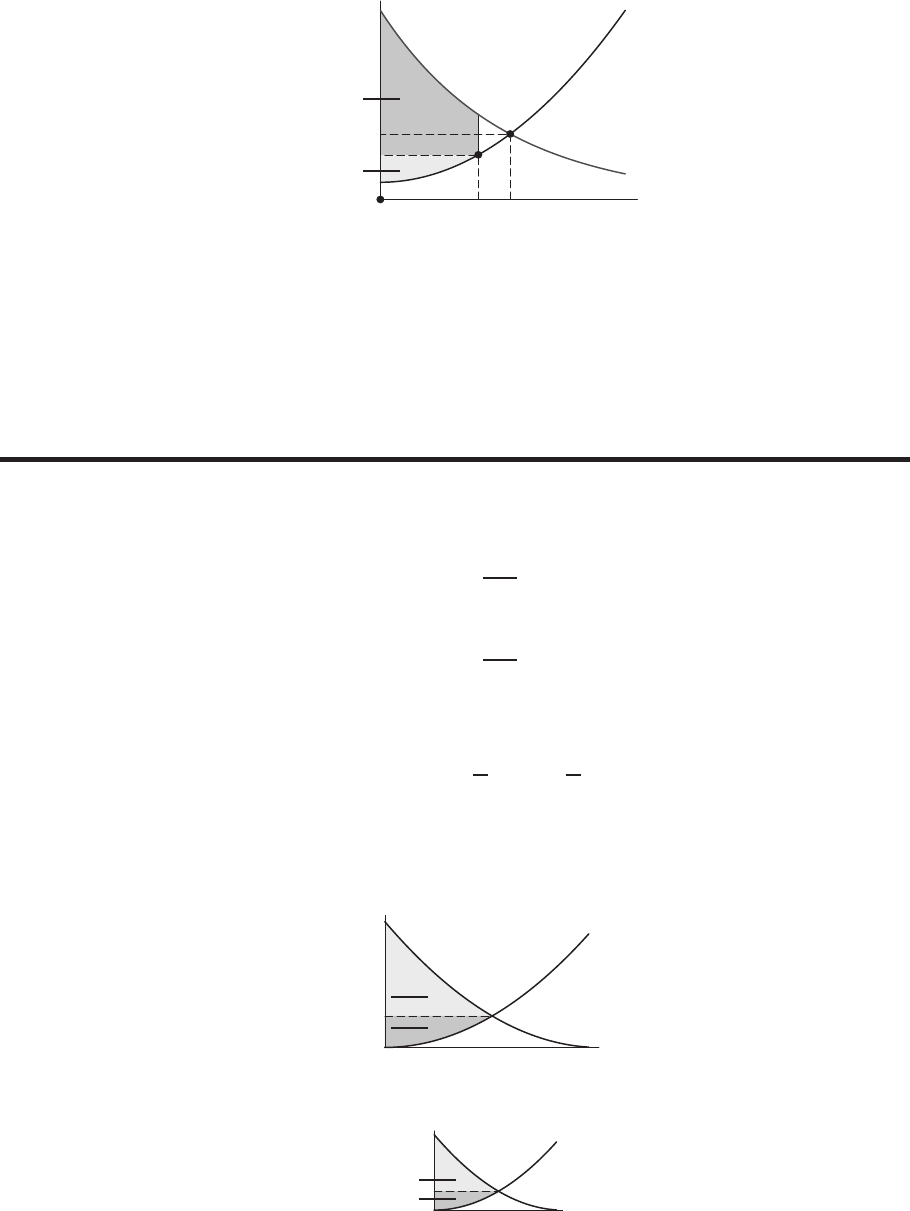
800 Chapter Eight /SOLUTIONS
40.
q−q∗
p−
p∗
quantity
price
✲
Producer surplus
✲
Consumer surplus
(a) The producer surplus is the area on the graph between p−and the supply function. Lowering the price also lowers
the producer surplus.
(b) Note that the consumer surplus—the area between the line p−and the supply curve—increases or decreases depend-
ing on the functions describing the supply and demand and on the lowered price. (For example, the consumer surplus
seems to be increased in the graph above, but if the price were brought down to $0 then the consumer surplus would
be zero, and hence clearly less than the consumer surplus at equilibrium.)
(c) The graph above shows that the total gains from the trade are decreased.
Strengthen Your Understanding
41. With no interest, the future value of the stream is equal to the total amount deposited over 10 years, which is $20,000. So
the future value is more than $20,000.
42. The present value of Sat a 4% interest rate, compounded annually, is
P V =S
1.04 .
The present value of Sat a 3% interest rate, compounded annually, is
P V =S
1.03 .
Thus, the present value is smaller with a 4% interest rate.
43. The present value of a continuous stream of payments is found using an integral:
PV =Z2
0
Pe−rtdt =−P
re−rt
2
0
=P
r(1 −e−2r).
44. Producer surplus is measured in dollars.
45. See Figure 8.124.
✲
Consumer surplus
✲
Producer surplus
Supply
Demand
x
y
Figure 8.124
✲
Consumer surplus
✲
Producer surplus
Supply
Demand
x
y
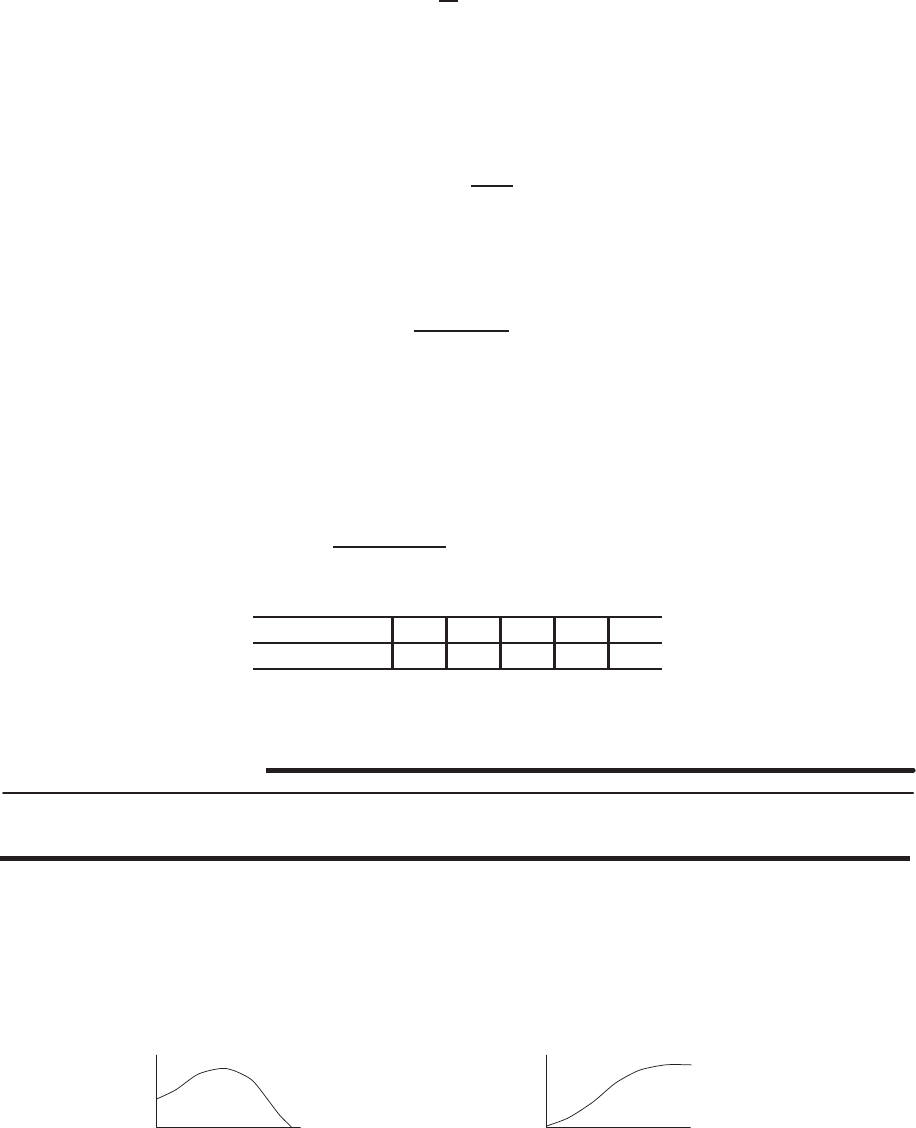
8.7 SOLUTIONS 801
46. We want 10,000e−r·10 <5000. Solving
e−10r= 0.5
r=−1
10 ln(0.5) = 0.0693.
We want an interest rate larger than 0.0693, such as 7% or larger.
Larger than 6.93%/ yr
47. A present value of Awith an interest rate r, compounded annually, has future value A(1 + r)after one year. Since we
want the future value to be $5000, we have
A(1 + r) = 5000
or
A=5000
1 + r.
Every choice of rgives a choice of A. For example, a 5% interest rate corresponds to r= 0.05 and gives A=
5000/1.05 = 4761.90. If the annual interest rate is 5%, then $4761.90 now has future value $5000 one year from
now.
48. Suppose there is an annual interest rate of 10%. Then the present value, A, of the $10,000 is:
A=10,000
(1 + 0.10)10 = 3855.
Thus, a deposit of roughly $3855 is needed now to have 10,000 dollars in 10 years, assuming a 10% interest rate.
There are two ways to think about the remaining values in the table. We can ask how much the amount needed now,
$3855, will grow to in tyears. This means the remaining values in the table arise by calculating:
3855(1 + 0.10)tfor t= 1,2,3,4.
Alternatively, we realize that a single deposit made tyears from now would have 10 −tyears to grow to reach our target
investment of $10,000 in 10 years. This means the remaining values in the table arise by calculating:
10,000
(1 + 0.10)10−t,for t= 1,2,3,4.
If we ignore rounding errors, we see that two approaches yield the same table values:
t(years from now) 0 1 2 3 4
$(dollars) 3855 4241 4665 5131 5644
Other possible answers to this problem can arise from alternate interest rate choices.
Solutions for Section 8.7
Exercises
1. The two humps of probability in density (a) correspond to two intervals on which its cumulative distribution function is
increasing. Thus (a) and (II) correspond.
A density function increases where its cumulative distribution function is concave up, and it decreases where its
cumulative distribution function is concave down. Density (b) matches the distribution with both concave up and concave
down sections, which is (I). Density (c) matches (III) which has a concave down section but no interval over which it is
concave up.
2.
income
% of population
per dollar of income
Figure 8.125
: Density function
income
% of population having
at least this income
Figure 8.126
: Cumulative distribution function
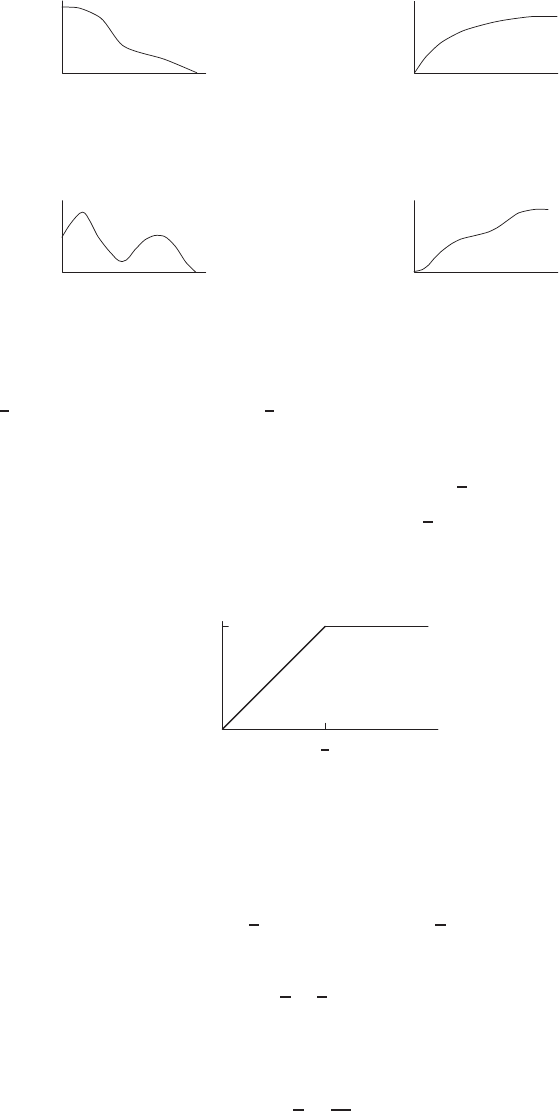
802 Chapter Eight /SOLUTIONS
3.
income
% of population
per dollar of income
Figure 8.127
: Density function
income
% of population having
at least this income
Figure 8.128
: Cumulative distribution function
4.
income
% of population
per dollar of income
Figure 8.129
: Density function
income
% of population having
at least this income
Figure 8.130
: Cumulative distribution function
5. Since the function takes on the value of 4, it cannot be a cdf (whose maximum value is 1). In addition, the function
decreases for x > c, which means that it is not a cdf. Thus, this function is a pdf. The area under a pdf is 1, so 4c= 1
giving c=1
4. The pdf is p(x) = 4 for 0≤x≤1
4, so the cdf is given in Figure 8.131 by
P(x) =
0for x < 0
4xfor 0≤x≤1
4
1for x > 1
4
1
4
1
x
P(x)
Figure 8.131
6. Since the function is decreasing, it cannot be a cdf (whose values never decrease). Thus, the function is a pdf.
The area under a pdf is 1, so, using the formula for the area of a triangle, we have
1
24c= 1,giving c=1
2.
The pdf is
p(x) = 1
2−1
8xfor 0≤x≤4,
so the cdf is given in Figure 8.132 by
P(x) =
0for x < 0
x
2−x2
16 for 0≤x≤4
1for x > 4.

8.7 SOLUTIONS 803
4
1
x
P(x)
Figure 8.132
7. Since the function levels off at the value of c, the area under the graph is not finite, so it is not 1. Thus, this function cannot
be a pdf.
It is a cdf and c= 1. The cdf is given by
P(x) =
0for x < 0
x
5for 0≤x≤5
1for x > 5.
The pdf in Figure 8.133 is given by
p(x) =
0for x < 0
1/5for 0≤x≤5
0for x > 5.
5
1/5
x
P(x)
Figure 8.133
8. This function decreases, so it cannot be a cdf. Since the graph must represent a pdf, the area under it is 1. The region
consists of two rectangles, each of base 0.5, and one of height 2cand one of height c, so
Area = 2c(0.5) + c(0.5) = 1
c=1
1.5=2
3
The pdf is therefore
p(x) =
0for x < 0
4/3for 0≤x≤0.5
2/3for 0.5< x ≤1
0for x > 1.
The cdf P(x)is the antiderivative of this function with P(0) = 0. See Figure 8.134. The formula for P(x)is
P(x) =
0for x < 0
4x/3for 0≤x≤0.5
2/3 + (2/3)(x−0.5) for 0.5< x ≤1
1for x > 1.
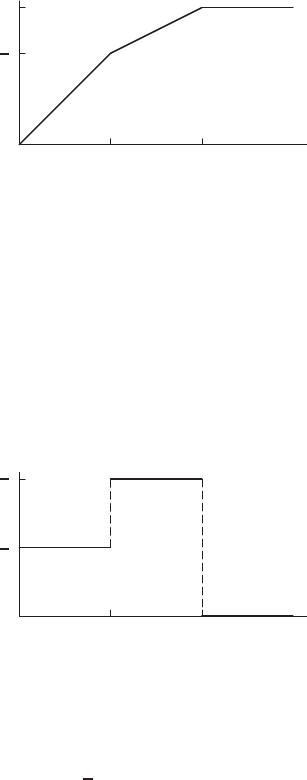
804 Chapter Eight /SOLUTIONS
0.5 1
2
3
1
x
P(x)
Figure 8.134
9. This function increases and levels off to c. The area under the curve is not finite, so it is not 1. Thus, the function must be
a cdf, not a pdf, and 3c= 1, so c= 1/3.
The pdf, p(x)is the derivative, or slope, of the function shown, so, using c= 1/3,
p(x) =
0for x < 0
(1/3−0)/(2 −0) = 1/6for 0≤x≤2
(1 −1/3)/(4 −2) = 1/3for 2< x ≤4
0for x > 4.
See Figure 8.135.
2 4
1
3
1
6
x
p(x)
Figure 8.135
10. This function does not level off to 1, and it is not always increasing. Thus, the function is a pdf. Since the area under the
curve must be 1, using the formula for the area of a triangle,
1
2·c·1 = 1 so c= 2.
Thus, the pdf is given by
p(x) =
0for x < 0
4xfor 0≤x≤0.5
2−4(x−0.5) = 4 −4xfor 0.5< x ≤1
0for x > 0.
To find the cdf, we integrate each part of the function separately, making sure that the constants of integration are arranged
so that the cdf is continuous.
Since R4xdx = 2x2+Cand P(0) = 0, we have 2(0)2+C= 0 so C= 0. Thus P(x) = 2x2on 0≤x≤0.5.
At x= 0.5, the cdf has value P(0.5) = 2(0.5)2= 0.5. Thus, we arrange that the integral of 4−4xgoes through the
point (0.5,0.5). Since R(4 −4x)dx = 4x−2x2+C, we have
4(0.5) −2(0.5)2+C= 0.5giving C=−1.
Thus
P(x) =
0for x < 0
2x2for 0≤x≤0.5
4x−2x2−1for 0.5< x ≤1
1 for x > 1.
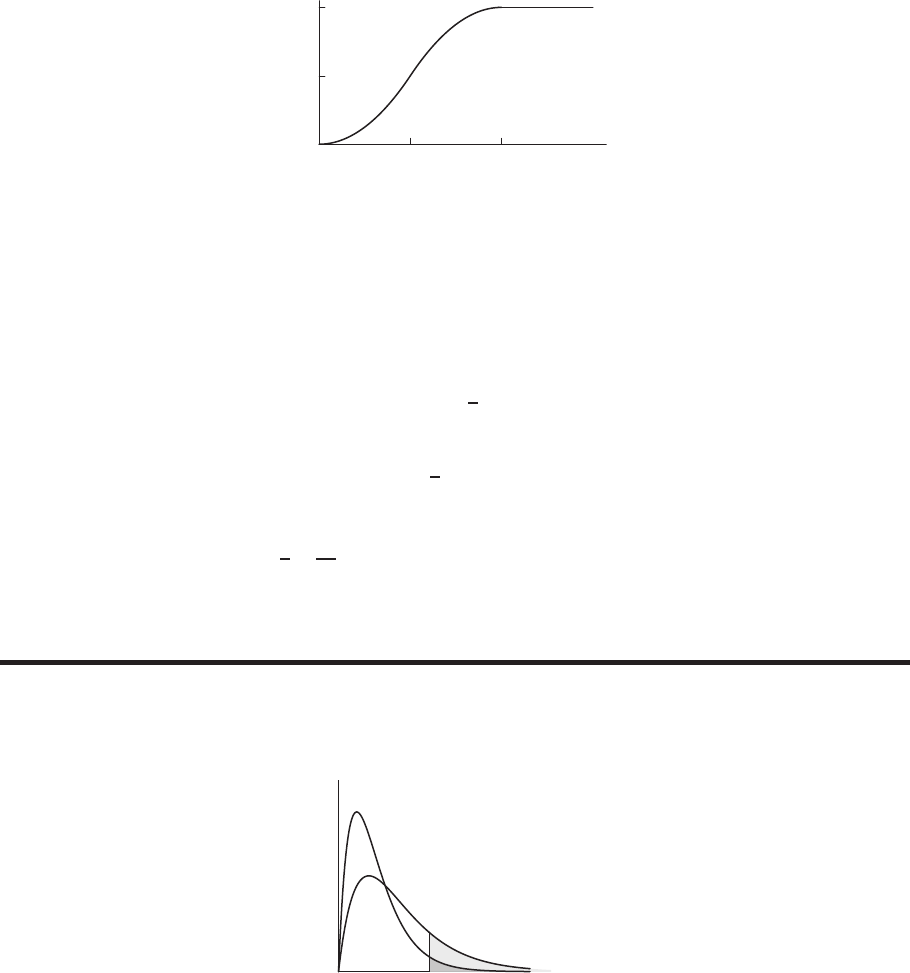
8.7 SOLUTIONS 805
See Figure 8.136.
0.5 1
0.5
1
x
P(x)
Figure 8.136
11. The statement p(70) = 0.05 means that for some small interval ∆xaround 70,the fraction of families with incomes in
that interval around $70,000 is about 0.05∆x.
12. We need to find a nonnegative function p(x)for which the area between y=p(x)and the xaxis is 1. One example is
a decreasing linear function p(x) = b+mx with m < 0.We choose band mso that p(5) = 0 and the triangular area
under the graph of p(x)for 0≤x≤5is 1.Since bis the height of the triangle, we have
Area =1
2b·5 = 1
or b= 2/5.Then p(5) = 0 gives
2
5+ 5m= 0
or m=−2/25.Thus
p(x) = 2
5−2
25 xwhen 0≤x≤5and p(x) = 0 otherwise.
Problems
13. For a given energy E, Figure 8.137 shows that the area under the graph to the right of Eis larger for graph Bthan it is for
graph A. Therefore graph Bhas more molecules at higher kinetic energies, so it is the hotter gas. So graph Acorresponds
to 300 kelvins and graph Bcorresponds to 500 kelvins.
E
A
B
energy
Figure 8.137
14. No. Though the density function has its maximum value at 50, this does not mean that a large fraction of the population
receives scores near 50. The value p(50) can not be interpreted as a probability. Probability corresponds to area under the
graph of a density function. Most of the area in this case is in the broad hump covering the range 0≤x≤40, very little
in the peak around x= 50. Most people score in the range 0≤x≤40.
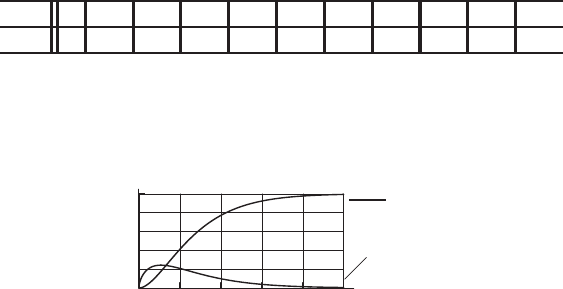
806 Chapter Eight /SOLUTIONS
15. (a) Let P(x)be the cumulative distribution function of the heights of the unfertilized plants. As do all cumulative
distribution functions, P(x)rises from 0 to 1 as xincreases. The greatest number of plants will have heights in the
range where P(x)rises the most. The steepest rise appears to occur at about x= 1 m. Reading from the graph we
see that P(0.9) ≈0.2and P(1.1) ≈0.8, so that approximately P(1.1) −P(0.9) = 0.8−0.2 = 0.6 = 60% of the
unfertilized plants grow to heights between 0.9 m and 1.1 m. Most of the plants grow to heights in the range 0.9 m to
1.1 m.
(b) Let PA(x)be the cumulative distribution function of the plants that were fertilized with A. Since PA(x)rises the
most in the range 0.7m≤x≤0.9m, many of the plants fertilized with A will have heights in the range 0.7 m to
0.9 m. Reading from the graph of PA, we find that PA(0.7) ≈0.2and PA(0.9) ≈0.8, so PA(0.9) −PA(0.7) ≈
0.8−0.2 = 0.6 = 60% of the plants fertilized with A have heights between 0.7 m and 0.9 m. Fertilizer A had the
effect of stunting the growth of the plants.
On the other hand, the cumulative distribution function PB(x)of the heights of the plants fertilized with B rises
the most in the range 1.1m≤x≤1.3m, so most of these plants have heights in the range 1.1 m to 1.3 m. Fertilizer
B caused the plants to grow about 0.2 m taller than they would have with no fertilizer.
16. (a) F(7) = 0.6tells us that 60% of the trees in the forest have height 7meters or less.
(b) F(7) > F (6). There are more trees of height less than 7meters than trees of height less than 6meters because every
tree of height ≤6meters also has height ≤7meters.
17. For a small interval ∆xaround 68, the fraction of the population of American men with heights in this interval is about
(0.2)∆x. For example, taking ∆x= 0.1, we can say that approximately (0.2)(0.1) = 0.02 = 2% of American men
have heights between 68 and 68.1inches.
18. We want to find the cumulative distribution function for the age density function. We see that P(10) is equal to 0.15 since
the table shows that 15% of the population is between 0 and 10 years of age. Also,
P(20) = Fraction of the population
between 0 and 20 years old = 0.15 + 0.14 = 0.29
and
P(30) = 0.15 + 0.14 + 0.14 = 0.43.
Continuing in this way, we obtain the values for P(t)shown in Table 8.7.
Table 8.7
Cumulative distribution function of ages in the US
t0 10 20 30 40 50 60 70 80 90 100
P(t)0 0.15 0.29 0.43 0.60 0.74 0.84 0.92 0.97 0.99 1.00
19. (a) The two functions are shown below. The choice is based on the fact that the cumulative distribution does not decrease.
(b) The cumulative distribution levels off to 1, so the top mark on the vertical scale must be 1.
2 4 6 8 10
0.2
0.4
0.6
0.8
1✛
Cumulative
✠
Density
The total area under the density function must be 1. Since the area under the density function is about 2.5boxes,
each box must have area 1/2.5 = 0.4. Since each box has a height of 0.2, the base must be 2.
20. (a) The area under the graph of the height density function p(x)is concentrated in two humps centered at 0.5 m and 1.1 m.
The plants can therefore be separated into two groups, those with heights in the range 0.3 m to 0.7 m, corresponding
to the first hump, and those with heights in the range 0.9 m to 1.3 m, corresponding to the second hump. This grouping
of the grasses according to height is probably close to the species grouping. Since the second hump contains more
area than the first, there are more plants of the tall grass species in the meadow.
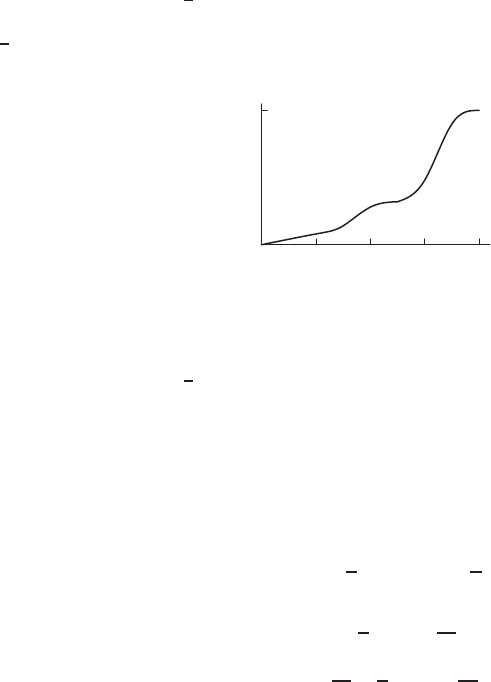
8.7 SOLUTIONS 807
(b) As do all cumulative distribution functions, the cumulative distribution function P(x)of grass heights rises from 0
to 1 as xincreases. Most of this rise is achieved in two spurts, the first as xgoes from 0.3 m to 0.7 m, and the second
as xgoes from 0.9 m to 1.3 m. The plants can therefore be separated into two groups, those with heights in the range
0.3 m to 0.7 m, corresponding to the first spurt, and those with heights in the range 0.9 m to 1.3 m, corresponding to
the second spurt. This grouping of the grasses according to height is the same as the grouping we made in part (a),
and is probably close to the species grouping.
(c) The fraction of grasses with height less than 0.7 m equals P(0.7) = 0.25 = 25%. The remaining 75% are the tall
grasses.
21. (a) The percentage of calls lasting from 1 to 2 minutes is given by the integral
Z2
1
p(x)dxZ2
1
0.4e−0.4xdx =e−0.4−e−0.8≈22.1%.
(b) A similar calculation (changing the limits of integration) gives the percentage of calls lasting 1 minute or less as
Z1
0
p(x)dx =Z1
0
0.4e−0.4xdx = 1 −e−0.4≈33.0%.
(c) The percentage of calls lasting 3 minutes or more is given by the improper integral
Z∞
3
p(x)dx= lim
b→∞ Zb
3
0.4e−0.4xdx = lim
b→∞(e−1.2−e−0.4b) = e−1.2≈30.1%.
(d) The cumulative distribution function is the integral of the probability density; thus,
C(h) = Zh
0
p(x)dx=Zh
0
0.4e−0.4xdx = 1 −e−0.4h.
22. (a) The fraction of students passing is given by the area under the curve from 2 to 4 divided by the total area under the
curve. This appears to be about 2
3.
(b) The fraction with honor grades corresponds to the area under the curve from 3 to 4 divided by the total area. This is
about 1
3.
(c) The peak around 2 probably exists because many students work to get just a passing grade.
(d)
1 2 3 4
1
GPA
fraction of students
23. (a) Most of the earth’s surface is below sea level. Much of the earth’s surface is either around 3 miles below sea level or
exactly at sea level. It appears that essentially all of the surface is between 4 miles below sea level and 2 miles above
sea level. Very little of the surface is around 1 mile below sea level.
(b) The fraction below sea level corresponds to the area under the curve from −4to 0 divided by the total area under the
curve. This appears to be about 3
4.
24. (a) We must have Z∞
0
f(t)dt = 1, for even though it is possible that any given person survives the disease, everyone
eventually dies. Therefore, Z∞
0
cte−ktdt = 1.
Integrating by parts gives
Zb
0
cte−ktdt =−c
kte−kt
b
0
+Zb
0
c
ke−ktdt
=−c
kte−kt −c
k2e−kt
b
0
=c
k2−c
kbe−kb −c
k2e−kb.
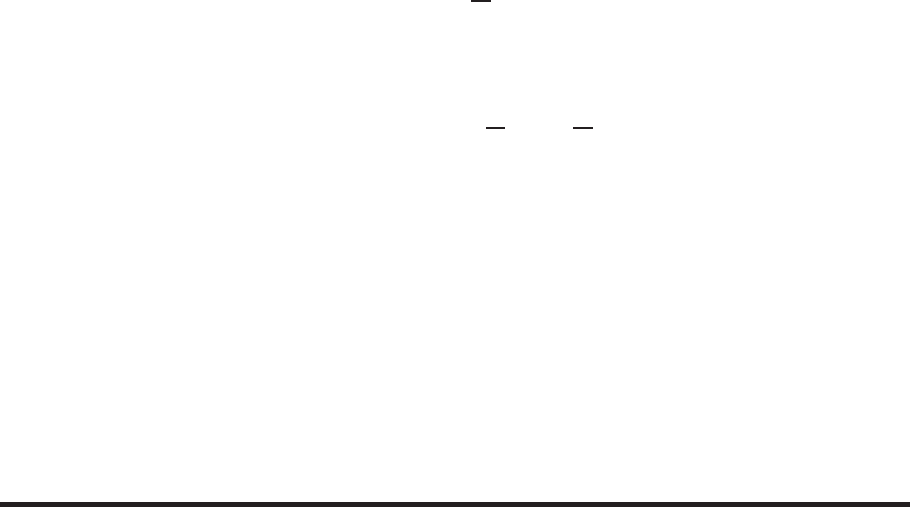
808 Chapter Eight /SOLUTIONS
As b→ ∞, we see Z∞
0
cte−ktdt =c
k2= 1 so c=k2.
(b) We are told that Z5
0
f(t)dt= 0.4, so using the fact that c=k2and the antiderivatives from part (a), we have
Z5
0
k2te−ktdt =−k2
kte−kt −k2
k2e−kt
5
0
= 1 −5ke−5k−e−5k= 0.4
so
5ke−5k+e−5k= 0.6.
Since this equation cannot be solved exactly, we use a calculator or computer to find k= 0.275. Since c=k2, we
have c= (0.275)2= 0.076.
(c) The cumulative death distribution function, C(t), represents the fraction of the population that have died up to time
t. Thus,
C(t) = Zt
0
k2xe−kxdx =−kxe−kx −e−kxt
0
= 1 −kte−kt −e−kt.
Strengthen Your Understanding
25. The fact that p(1) = 0.02 tells us that the probability that xfalls in a small interval of length ∆xaround 1 is 0.02∆x.
26. The cumulative distribution gives the probability that xis less than some value. Thus, P(5) = 0.4means that the
probability that xis less that 5 is 0.4.
27. Every density function p(t)satisfies the equation R∞
−∞p(t)dt = 1. Since R∞
−∞ t2dt =∞, the function p(t) = t2is not
a density function.
28. Since this function is increasing for x > 0,the area under its graph increases without bound. So the area under the graph
of this function is not equal to 1.
29. As x→ ∞ the function P(x) = x2exgrows without bound, whereas a cumulative distribution function must approach
1.
30. Every cumulative distribution is a nondecreasing function, but P(t) = e−t2is decreasing for t>0.
31. A cumulative distribution function is increasing for all values of x; a probability density function is not.
32. We can take
p(x) = n1/20,0≤x≤20
0,otherwise.
It is a density function because p(x)≥0for 0≤x≤20 and R∞
−∞p(x)dx = 1.
33. We can use
P(t) = (0, t < 0
t, 0≤t≤1
1, t > 1.
It is a cumulative distribution function because P(t)is an increasing function that increases from 0 to 1.
34. One possible density function is given by
p(x) =
0x<2
1/5 2 ≤x≤7
0 7 < x.
This function is nonzero only between x= 2 and x= 7 and has R∞
−∞p(x)dx = 1.
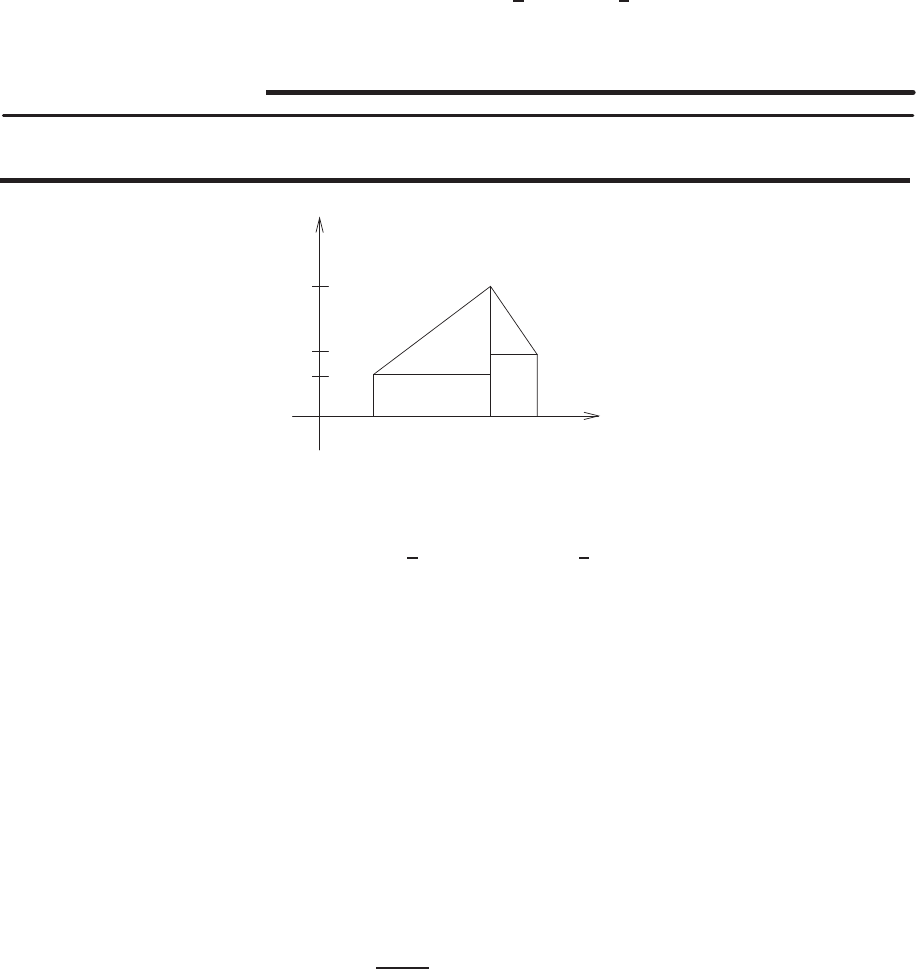
8.8 SOLUTIONS 809
35. The cumulative distribution function increases between x= 3 and x= 7. One possible cumulative distribution function
is
P(x) =
0x < 3
1/4(x−3) 3 ≤x≤7
1x > 7.
36. False. Since p(x)<0for x < 0, it cannot be a probability density function.
37. False. It is true that p(x)≥0for all x, but we also need R∞
−∞p(x)dx = 1. Since p(x) = 0 for x≤0, we need only
check the integral from 0to ∞. We have
Z∞
0
xe−x2dx = lim
b→∞ −1
2e−x2
b
0
=1
2.
Solutions for Section 8.8
Exercises
1.
0.24
0
0.08
0.12
p(x)
A1
A2A4
A3
2 6 8
x(tons of fish)
Splitting the figure into four pieces, we see that
Area under the curve =A1+A2+A3+A4
=1
2(0.16)4 + 4(0.08) + 1
2(0.12)2 + 2(0.12)
= 1.
We expect the area to be 1, since Z∞
−∞
p(x)dx = 1 for any probability density function, and p(x)is 0except when
2≤x≤8.
2. Recall that the mean is Z∞
−∞
xp(x)dx. In the fishing example, p(x) = 0 except when 2≤x≤8, so the mean is
Z8
2
xp(x)dx.
Using the equation for p(x)from the graph,
Z8
2
xp(x)dx =Z6
2
xp(x)dx +Z8
6
xp(x)dx
=Z6
2
x(0.04x)dx +Z8
6
x(−0.06x+ 0.6) dx
=0.04x3
3
6
2
+−0.02x3+ 0.3x2
8
6
≈5.253 tons.
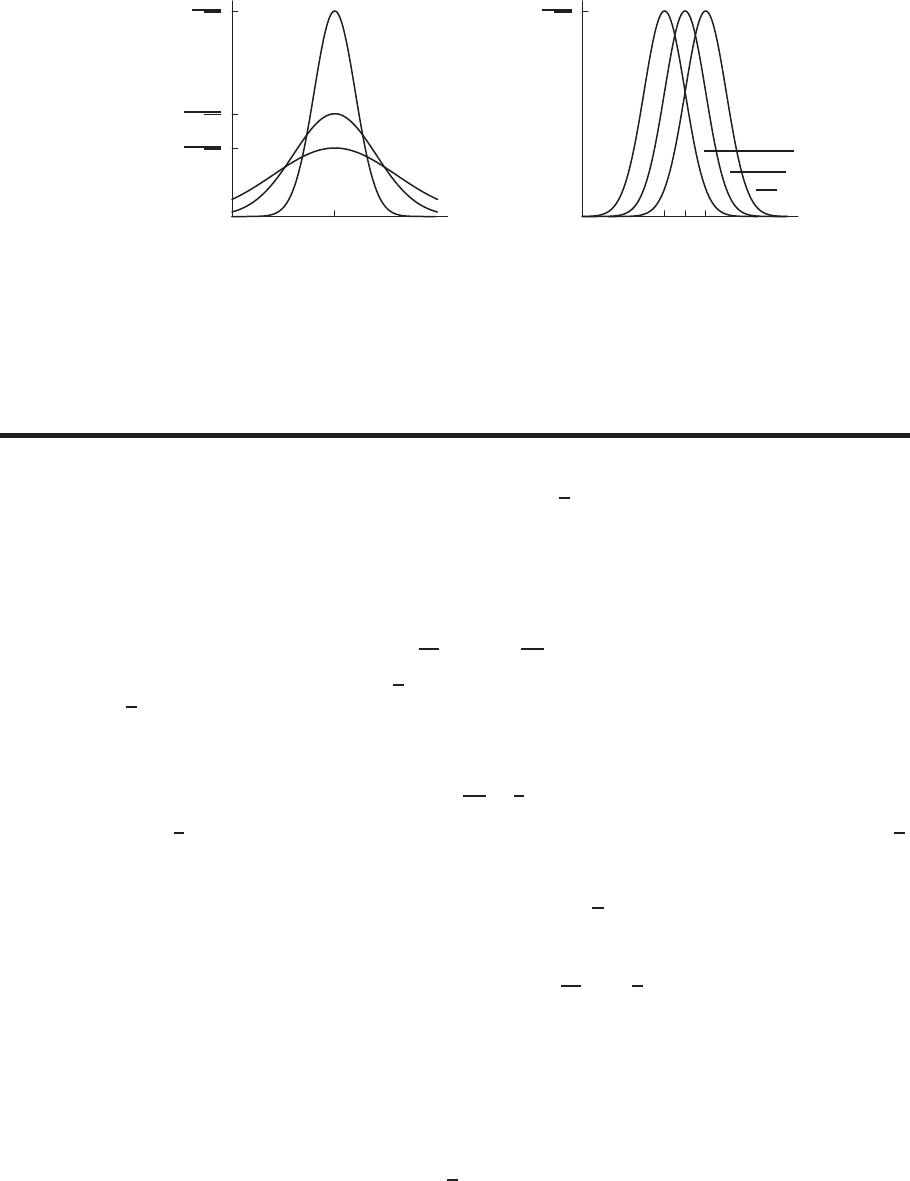
810 Chapter Eight /SOLUTIONS
3. (a)
5
1
3√2π
1
2√2π
1
√2π
σ= 1
σ= 2
σ= 3
x
p(x)
(i)
4 5 6
1
√2π
✛µ= 4
✛µ= 5
✛µ= 6
x
p(x)
(ii)
(b) Recall that the mean is the “balancing point.” In other words, if the area under the curve was made of cardboard, we’d
expect it to balance at the mean. All of the graphs are symmetric across the line x=µ, so µis the “balancing point”
and hence the mean.
As the graphs also show, increasing σflattens out the graph, in effect lessening the concentration of the data near the
mean. Thus, the smaller the σvalue, the more data is clustered around the mean.
Problems
4. The mean is the value of the integral Z2
0
x·0.5(2 −x)dx =2
3.
The median is the value of Tsuch that ZT
0
0.5(2 −x)dx = 0.5.
Integrating gives the equation
x−0.5x2
2
T
0
=T−T2
4= 0.5
which is a quadratic with solutions T= 2 ±√2.Since the median must be between 0and 2,the solution we want is
T= 2 −√2 = 0.586.
5. The median is the value of Tsuch that P(T) = 0.5,so we solve
T−T2
4=1
2
to get T= 2 ±√2.Since the median is between 0and 2we discard the larger solution, so the median is T= 2 −√2.
To find the mean, we first calculate the probability density
Density =p(x) = P′(x) = 1 −x
2
and then evaluate the integral
Mean =Z2
0
xp(x)dx =Z2
0
x−x2
2dx =2
3.
So the mean is 2/3.
6. (a) Since d(e−ct)/dt =ce−ct , we have
cZ6
0
e−ctdt =−e−ct6
0= 1 −e−6c= 0.1,
so
c=−1
6ln 0.9≈0.0176.

8.8 SOLUTIONS 811
(b) Similarly, with c= 0.0176, we have
cZ12
6
e−ctdt =−e−ct12
6
=e−6c−e−12c= 0.9−0.81 = 0.09,
so the probability is 9%.
7. (a) We can find the proportion of students by integrating the density p(x)between x= 1.5and x= 2:
P(2) −P(1.5) = Z2
1.5
x3
4dx
=x4
16
2
1.5
=(2)4
16 −(1.5)4
16 = 0.684,
so that the proportion is 0.684 : 1 or 68.4%.
(b) We find the mean by integrating xtimes the density over the relevant range:
Mean =Z2
0
xx3
4dx
=Z2
0
x4
4dx
=x5
20
2
0
=25
20 = 1.6hours.
(c) The median will be the time Tsuch that exactly half of the students are finished by time T, or in other words
1
2=ZT
0
x3
4dx
1
2=x4
16
T
0
1
2=T4
16
T=4
√8 = 1.682 hours.
8. (a) Since Z∞
0
p(x)dx= 1,we have
1 = Z∞
0
ae−0.122xdx
=a
−0.122 e−0.122x
∞
0
=a
0.122 .
So a= 0.122.
(b)
P(x) = Zx
0
p(t)dt
=Zx
0
0.122e−0.122tdt
=−e0.122tx
0= 1 −e−0.122x.
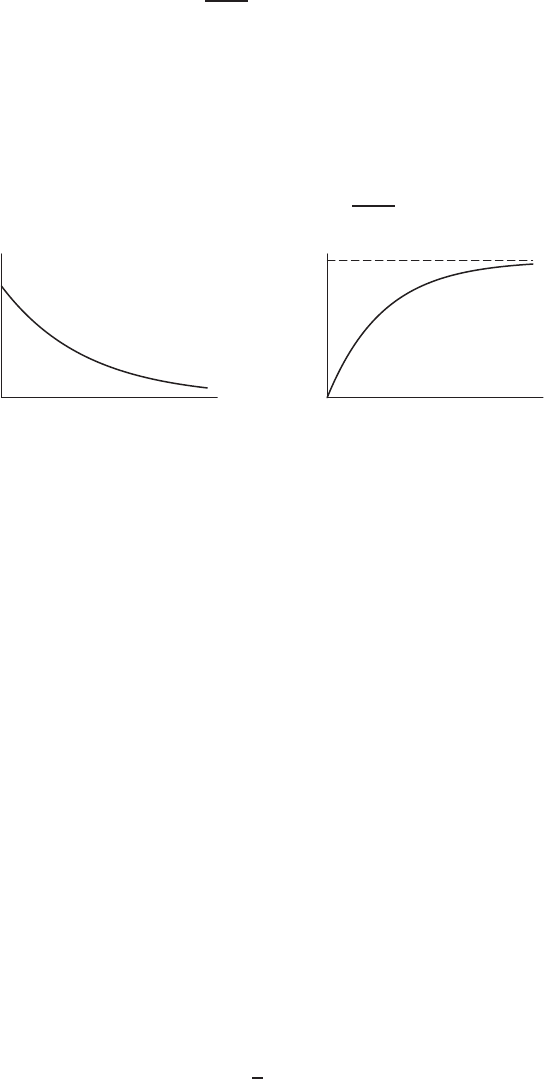
812 Chapter Eight /SOLUTIONS
(c) Median is the xsuch that
P(x) = 1 −e−0.122x= 0.5.
So e−0.122x= 0.5. Thus,
x=−ln 0.5
0.122 ≈5.68 seconds
and
Mean =Z∞
0
x(0.122)e−0.122xdx =−Z∞
0
x−0.122e−0.122xdx.
We now use integration by parts. Let u=−xand v′=−0.122e−0.122x. Then u′=−1, and v=e−0.122x.
Therefore,
Mean =−xe−0.122x
∞
0
+Z∞
0
e−0.122xdx =1
0.122 ≈8.20 seconds.
(d)
0.122 p(x)
x
1
P(x)
x
9. (a) The cumulative distribution function
P(t) = Zt
0
p(x)dx =Area under graph of density function p(x)for 0≤x≤t
=Fraction of population who survive tyears or less after treatment
=Fraction of population who survive up to tyears after treatment.
(b) The probability that a randomly selected person survives for at least tyears is the probability that he lives tyears or
longer, so
S(t) = Z∞
t
p(x)dx= lim
b→∞ Zb
t
Ce−Ct dx
= lim
b→∞ −e−Ct
b
t
= lim
b→∞ −e−Cb −(−e−Ct) = e−Ct,
or equivalently,
S(t) = 1 −Zt
0
p(x)dx= 1 −Zt
0
Ce−Ct dx = 1 + e−Ct
t
0
= 1 + (e−Ct −1) = e−Ct.
(c) The probability of surviving at least two years is
S(2) = e−C(2) = 0.70
so
ln e−C(2) = ln 0.70
−2C= ln 0.7
C=−1
2ln 0.7≈0.178.
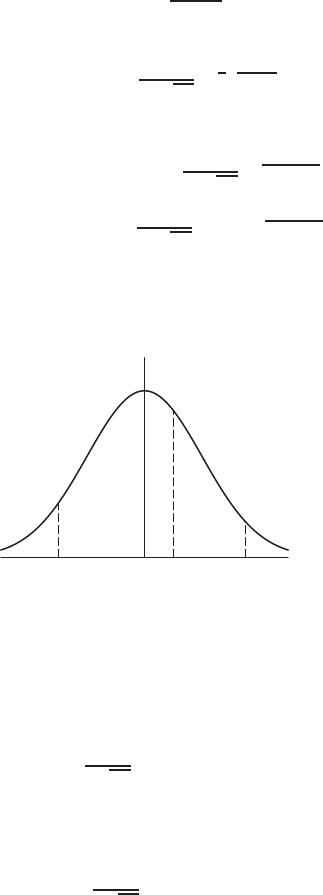
8.8 SOLUTIONS 813
10. (a) The probability you dropped the glove within a kilometer of home is given by
Z1
0
2e−2xdx =−e−2x
1
0
=−e−2+ 1 ≈0.865.
(b) Since the probability that the glove was dropped within ykm =Ry
0p(x)dx= 1 −e−2y, we solve
1−e−2y= 0.95
e−2y= 0.05
y=ln 0.05
−2≈1.5km.
11. (a) Since µ= 100 and σ= 15:
p(x) = 1
15√2πe−1
2(x−100
15 )2
.
(b) The fraction of the population with IQ scores between 115 and 120 is (integrating numerically)
Z120
115
p(x)dx =Z120
115
1
15√2πe−(x−100)2
450 dx
=1
15√2πZ120
115
e−(x−100)2
450 dx
≈0.067 = 6.7% of the population.
12. (a) The normal distribution of car speeds with µ= 58 and σ= 4 is shown in Figure 8.138.
52
µ= 58
60 65
x
Figure 8.138
The probability that a randomly selected car is going between 60 and 65 is equal to the area under the curve
from x= 60 to x= 65,
Probability =1
4√2πZ65
60
e−(x−58)2/(2·42)dx ≈0.2685.
We obtain the value 0.2685 using a calculator or computer.
(b) To find the fraction of cars going under 52 km/hr, we evaluate the integral
Fraction =1
4√2πZ52
0
e−(x−58)2/32dx ≈0.067.
Thus, approximately 6.7% of the cars are going less than 52 km/hr.

814 Chapter Eight /SOLUTIONS
13. (a) First, we find the critical points of p(x):
d
dx p(x) = 1
σ√2π−2(x−µ)
2σ2e−(x−µ)2
2σ2
=−(x−µ)
σ3√2πe−(x−µ)2
2σ2.
This implies x=µis the only critical point of p(x).
To confirm that p(x)is maximized at x=µ, we rely on the first derivative test. As −1
σ3√2πe−(x−µ)2
2σ2is
always negative, the sign of p′(x)is the opposite of the sign of (x−µ); thus p′(x)>0when x < µ, and p′(x)<0
when x > µ.
(b) To find the inflection points, we need to find where p′′(x)changes sign; that will happen only when p′′(x) = 0. As
d2
dx2p(x) = −1
σ3√2πe−(x−µ)2
2σ2−(x−µ)2
σ2+ 1,
p′′(x)changes sign when −(x−µ)2
σ2+ 1does, since the sign of the other factor is always negative. This occurs
when
−(x−µ)2
σ2+ 1 = 0,
−(x−µ)2=−σ2,
x−µ=±σ.
Thus, x=µ+σor x=µ−σ. Since p′′(x)>0for x < µ−σand x > µ+σand p′′(x)<0for µ−σ≤x≤µ+σ,
these are in fact points of inflection.
(c) µrepresents the mean of the distribution, while σis the standard deviation. In other words, σgives a measure of the
“spread” of the distribution, i.e., how tightly the observations are clustered about the mean. A small σtells us that
most of the data are close to the mean; a large σtells us that the data is spread out.
14. The fraction of the population within one standard deviation of the mean is given by
Fraction within σof mean =Zσ
−σ
1
√2πσ e−x2/(2σ2)dx.
Let us substitute w=x
σso that dw =1
σdx, and when x=±σ,w=±1. Then we have
Fraction =Zσ
−σ
1
√2πσ e−x2/(2σ2)dx =Z1
−1
1
√2πσ e−w2/2·σdw =Z1
−1
1
√2πe−w2/2dw.
This integral is independent of σ. Evaluating the integral numerically gives 0.68, showing that about 68% of the population
lies within one standard deviation of the mean.
15. It is not (a) since a probability density must be a non-negative function; not (c) since the total integral of a probability
density must be 1; (b) and (d) are probability density functions, but (d) is not a good model. According to (d), the
probability that the next customer comes after 4 minutes is 0. In real life there should be a positive probability of not
having a customer in the next 4 minutes. So (b) is the best answer.
16. (a) Since Pis the cumulative distribution function, the percentage of households that made between $40,000 and
$60,000 is
P(60) −P(40) = 66.8% −50.1% = 16.7%.
Therefore 16.7% of the households made between $40,000 and $60,000.
The percentage of households making over $100,000 is 100% −87.1% = 12.9%.
(b) The median income is the income such that half the households make less than this amount. Looking at the table,
we see that the 50% mark occurs between $20,000 and $40,000. Since P(20) = 29.5%, we know 29.5% of the
households made less than $20,000. Assuming local linearity we calculate the slope of the line connecting (20,29.5)
with (40,50.1) as (50.1−29.5)/20 = 1.03. If xis the additional income it takes to achieve the median, then
1.03x= 50.0−29.5, so x= 19.90. Since 20 + 19.90 = 39.90, the median income is approximately $39,900. This
looks sensible since just over 50% of the population earn $40,000.
(c) The percentage of households that made between $40,000 and $75,000 is 76.2−50.1 = 26.1. Since this percentage
is less than 1/3, the statement is false.
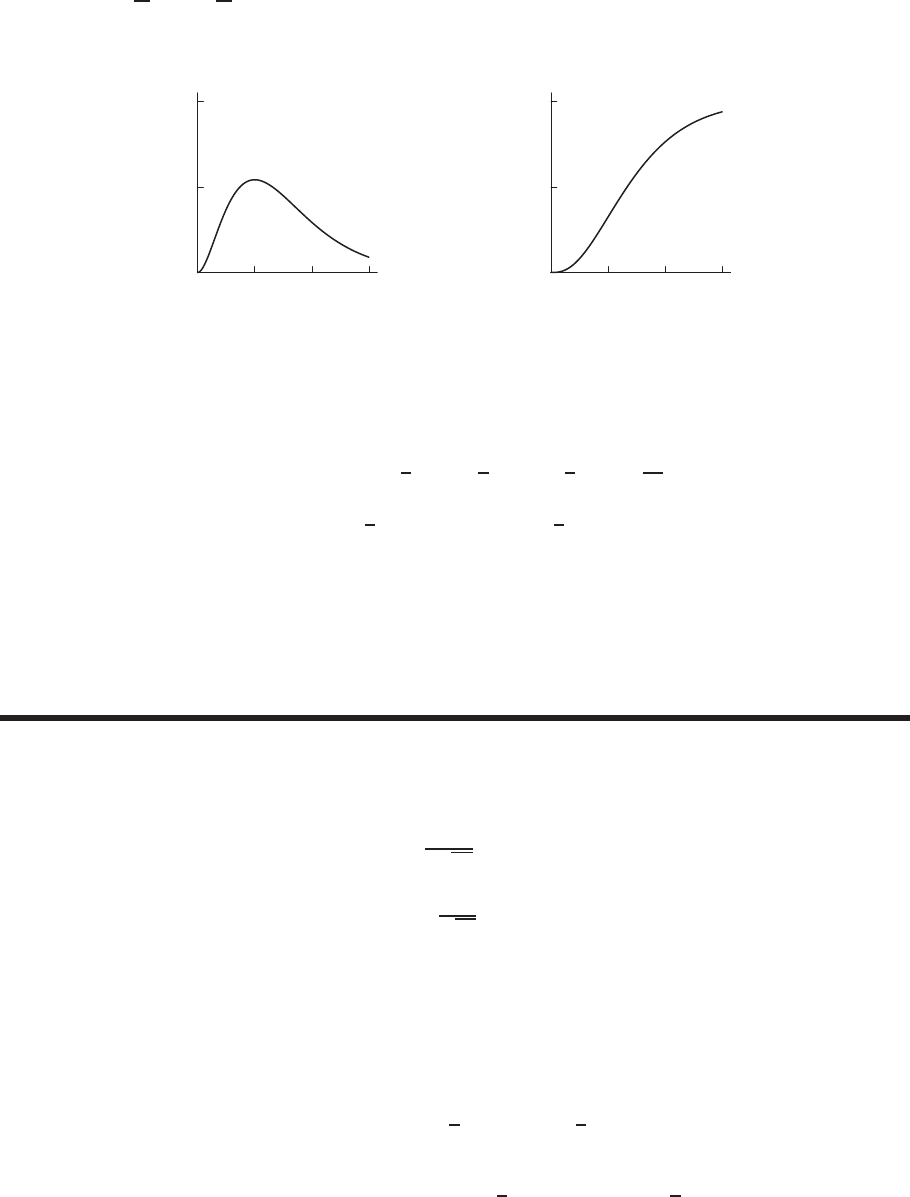
8.8 SOLUTIONS 815
17. (a) Let the p(r)be the density function. Then P(r) = Rr
0p(x)dx, and from the Fundamental Theorem of Calculus,
p(r) = d
dr P(r) = d
dr (1 −(2r2+ 2r+ 1)e−2r) = −(4r+ 2)e−2r+ 2(2r2+ 2r+ 1)e−2r, or p(r) = 4r2e−2r.
We have that p′(r) = 8r(e−2r)−8r2e−2r=e−2r·8r(1 −r), which is zero when r= 0 or r= 1, negative
when r > 1, and positive when r < 1. Thus p(1) = 4e−2≈0.54 is a relative maximum.
Here are sketches of p(r)and the cumulative position P(r):
123
0.5
1
p(r)
r
123
0.5
1P(r)
r
(b) The median distance is the distance rsuch that P(r) = 1 −(2r2+ 2r+ 1)e−2r= 0.5, or equivalently, (2r2+ 2r+
1)e−2r= 0.5.
By experimentation with a calculator, we find that r≈1.33 Bohr radii is the median distance.
The mean distance is equal to the value of the integral R∞
0rp(r)dr = lim
x→∞ Rx
0rp(r)dr. We have that
Rx
0rp(r)dr =Rx
04r3e−2rdr. Using the integral table, we get
Zx
0
4r3e−2rdr=h−1
24r3−1
4(12r2)−1
8(24r)−1
16 (24)ie−2x
x
0
=3
2−h2x3+ 3x2+ 3x+3
2ie−2x.
Taking the limit of this expression as x→ ∞, we see that all terms involving (powers of xor constants) ·e−2xhave
limit 0, and thus the mean distance is 1.5Bohr radii.
The most likely distance is obtained by maximizing p(r) = 4r2e−2r; as we have already seen this corresponds
to r= 1 Bohr unit.
(c) Because it is the most likely distance of the electron from the nucleus.
Strengthen Your Understanding
18. A median satisfies P(T) = 0.5where Pis the cumulative distribution function.
19. The median is the value which divides the area under the density function graph into halves. The median of this function
cannot be 1since all of the area is to the left of x= 1.The median is between 0and 1.
20. We can use the normal distribution
p(x) = 1
σ√2πe−(x−µ)2/(2σ2)
with µ=σ= 1/2to get
p(x) = 2
√2πe−2(x−1/2)2.
21. We can take a constant, or uniform distribution
p(x) =
0for x < 0
1for 0≤x≤1
0for x > 1.
Since Z1
0
x dx =1
2,the mean is 1
2.
Since Z1/2
0
p(x)dx =Z1/2
0
1dx =1
2,the median is also 1
2.
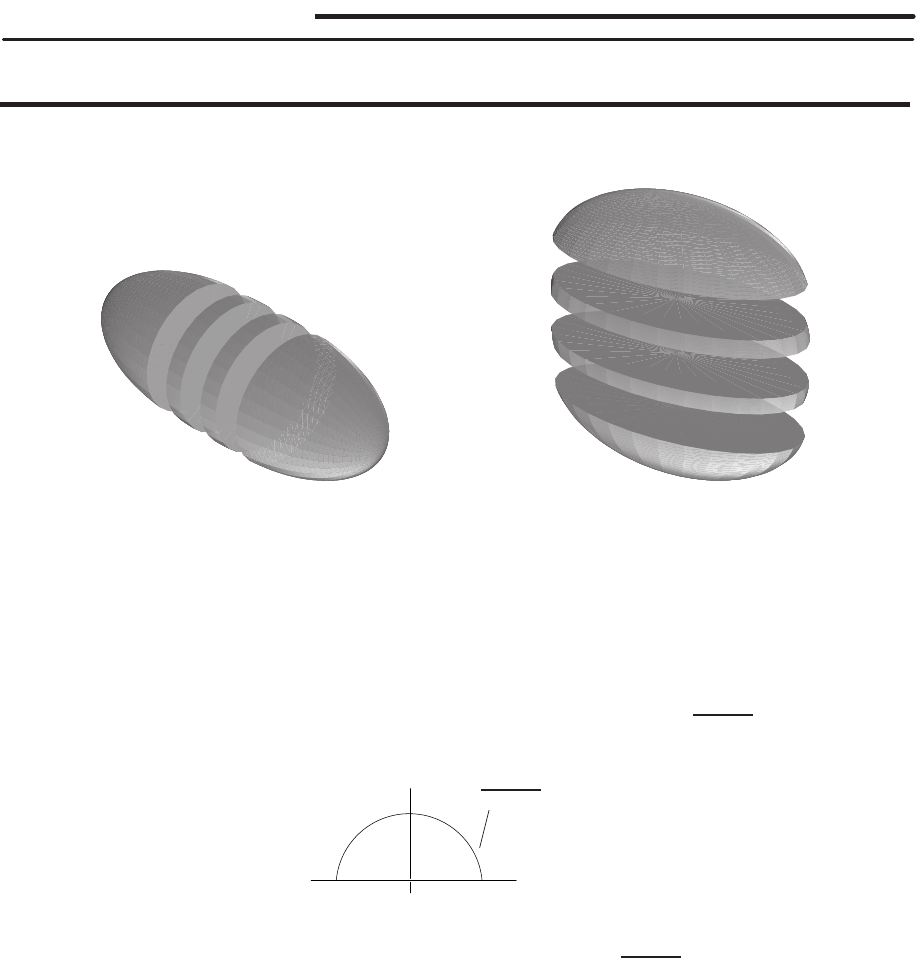
816 Chapter Eight /SOLUTIONS
22. False. Note that pis the density function for the population, not the cumulative density function. Thus p(10) = 1/2means
that the probability of xlying in a small interval of length ∆xaround x= 10 is about (1/2)∆x.
23. True. This follows directly from the definition of the cumulative density function.
24. True. The interval from x= 9.98 to x= 10.04 has length 0.06. Assuming that the value of p(x)is near 1/2for
9.98 < x < 10.04, the fraction of the population in that interval is R10.04
9.98 p(x)dx ≈(1/2)(0.06) = 0.03.
25. False. Note that pis the density function for the population, not the cumulative density function. Thus p(10) = p(20)
means that xvalues near 10 are as likely as xvalues near 20.
26. True. By the definition of the cumulative distribution function, P(20) −P(10) = 0 is the fraction of the population
having xvalues between 10 and 20.
Solutions for Chapter 8 Review
Exercises
1. Vertical slices are circular. Horizontal slices would be similar to ellipses in cross-section, or at least ovals (a word derived
from ovum, the Latin word for egg).
Figure 8.139
2. The limits of integration are 0and b, and the rectangle represents the region under the curve f(x) = hbetween these
limits. Thus,
Area of rectangle =Zb
0
h dx =hx
b
0
=hb.
3. The circle x2+y2=r2cannot be expressed as a function y=f(x), since for every xwith −r < x < r, there are two
corresponding yvalues on the circle. However, if we consider the top half of the circle only, as shown below, we have
x2+y2=r2, or y2=r2−x2, and taking the positive square root, we have that y=√r2−x2is the equation of the
top semicircle.
✎
−rr
y=√r2−x2
Then
Area of Circle = 2(Area of semicircle) = 2 Zr
−rpr2−x2dx
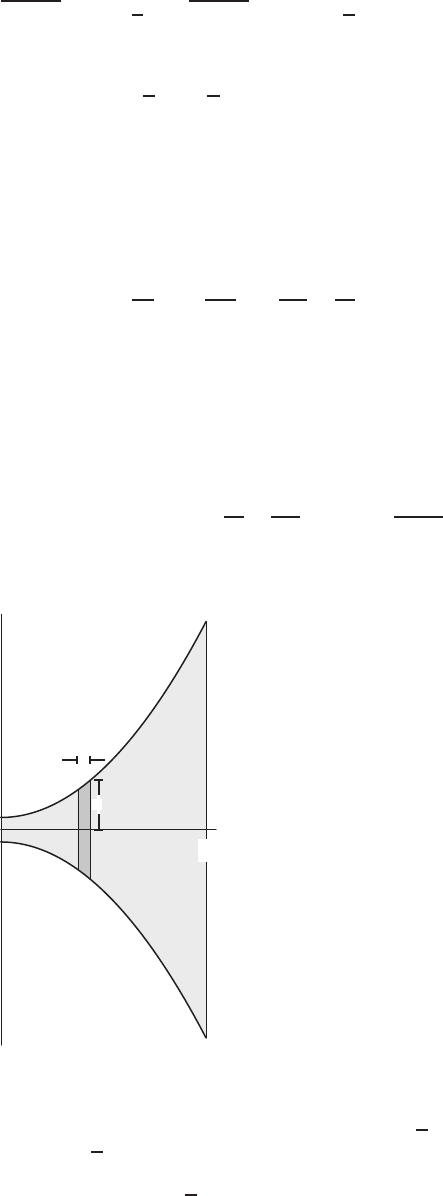
SOLUTIONS to Review Problems for Chapter Eight 817
We evaluate this using integral table formula 30.
2Zx=r
x=−rpr2−x2dx = 2 h1
2xpr2−x2+r2arcsin x
ri
r
−r
=r2(arcsin 1 −arcsin(−1))
=r2π
2−−π
2=πr2.
4. Name the slanted line y=f(x). Then the triangle is the region under the line y=f(x)and between the lines y= 0 and
x=b. Thus,
Area of triangle =Zb
0
f(x)dx.
Since f(x)is a line of slope h/b which passes through the origin, its equation is f(x) = hx/b. Thus,
Area of triangle =Zb
0
hx
bdx =hx2
2b
b
0
=hb2
2b=hb
2.
5. We slice the region vertically. Each rotated slice is approximately a cylinder with radius y=x2+ 1 and thickness ∆x.
See Figure 8.140. The volume of a typical slice is π(x2+ 1)2∆x. The volume, V, of the object is the sum of the volumes
of the slices:
V≈Xπ(x2+1)2∆x.
As ∆x→0we obtain an integral.
V=Z4
0
π(x2+ 1)2dx =πZ4
0
(x4+ 2x2+ 1)dx =πx5
5+2x3
3+x
4
0
=3772π
15 = 790.006.
4
✲ ✛
∆x
✻
❄
y
y=x2+ 1
x
y
Figure 8.140
6. We slice the region vertically. Each rotated slice is approximately a cylinder with radius y=√xand thickness ∆x. See
Figure 8.141. The volume of a typical slice is π(√x)2∆x. The volume, V, of the object is the sum of the volumes of the
slices:
V≈Xπ(√x)2∆x.

818 Chapter Eight /SOLUTIONS
As ∆x→0we obtain an integral.
V=Z2
1
π(√x)2dx =πZ2
1
xdx =πx2
2
2
1
=3π
2= 4.712.
1 2
✲ ✛
∆x
✻
❄
y
y=√x
x
y
Figure 8.141
7. We slice the region vertically. Each rotated slice is approximately a cylinder with radius y=e−2xand thickness ∆x. See
Figure 8.142. The volume of a typical slice is π(e−2x)2∆x. The volume, V, of the object is the sum of the volumes of
the slices:
V≈Xπ(e−2x)2∆x.
As ∆x→0we obtain an integral.
V=Z1
0
π(e−2x)2dx =πZ1
0
e−4xdx =π−1
4(e−4x)
1
0
=−π
4(e−4−1) = 0.771.
1
✲ ✛
∆x
✻
❄
yy=e−2x
x
y
Figure 8.142
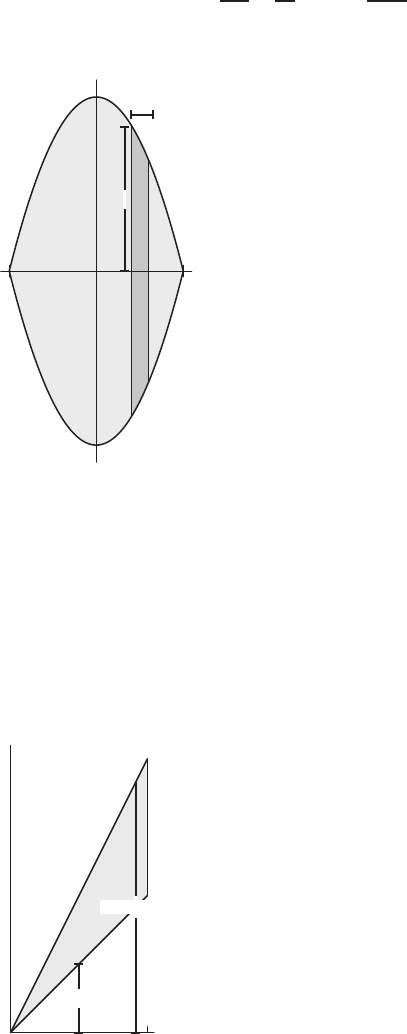
SOLUTIONS to Review Problems for Chapter Eight 819
8. We slice the region vertically. Each rotated slice is approximately a cylinder with radius y= 4 −x2and thickness ∆x.
See Figure 8.143. The volume, V, of a typical slice is π(4 −x2)2∆x. The volume of the object is the sum of the volumes
of the slices:
V≈Xπ(4−x2)2∆x.
As ∆x→0we obtain an integral. Since the region lies between x=−2and x= 2, we have:
V=Z2
−2
π(4 −x2)2dx =πZ2
−2
(16 −8x2+x4)dx =π16x−8x3
3+x5
5
2
−2
=512π
15 = 107.233.
−2 2
✲✛
∆x
✻
❄
y
y= 4 −x2
x
y
Figure 8.143
9. We divide the region into vertical strips of thickness ∆x. As a slice is rotated about the x-axis, it creates a disk of radius
rout from which has been removed a smaller circular disk of inside radius rin. We see in Figure 8.144 that rout = 2xand
rin =x. Thus,
Volume of a slice ≈π(rout)2∆x−π(rin)2∆x=π(2x)2∆x−π(x)2∆x.
To find the total volume, V, we integrate this quantity between x= 0 and x= 3:
V=Z3
0
(π(2x)2−π(x)2)dx =πZ3
0
(4x2−x2)dx =πZ3
0
3x2dx =πx3
3
0
= 27π= 84.823.
3
y=x
y= 2x
✻
❄
rout = 2x
✻
❄
rin =x
x
y
Figure 8.144
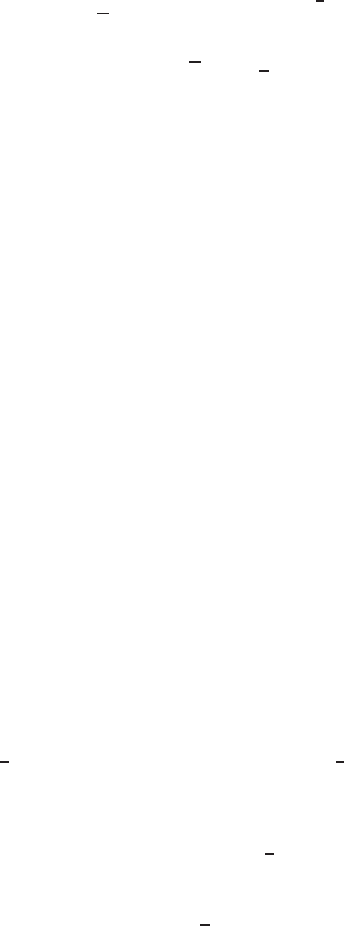
820 Chapter Eight /SOLUTIONS
10. The two functions intersect at (0,0) and (8,2). We slice the volume with planes perpendicular to the x-axis. This divides
the solid into thin washers with
Volume of slice =πr2
out∆x−πr2
in∆x.
The inner radius is the vertical distance from the x-axis to the curve y=1
4x. Similarly, the outer radius is the vertical
distances from the x-axis to the curve y=3
√x. Integrating from x= 0 to x= 8 we have
V=Z8
0hπ(3
√x)2−π(1
4x)2idx.
11. The region is bounded by y= 2, the y-axis and y=x1/3. The two functions y= 2 and y=x1/3intersect at (8,2). We
slice the volume with planes that are perpendicular to the y-axis. This divides the solid into thin cylinders with
Volume ≈πr2∆y.
The radius is the distance from the y-axis to the curve x=y3. Integrating from y= 0 to y= 2 we have
V=Z2
0
π(y3)2dy.
12. The region is bounded by y= 2, the y-axis and y=x1/3. The two functions y= 2 and y=x1/3intersect at (8,2). We
slice the volume with planes that are perpendicular to the line y=−2. This divides the solid into thin washers with
Volume ≈πr2
out∆x−πr2
in∆x.
The inner radius is the distance from the line y=−2to the curve y=x1/3and the outer radius is the distance from the
line y=−2to the line y= 2. Integrating from x= 0 to x= 8 we have
V=Z8
0π(2−(−2))2−π(x1/3−(−2))2dx.
13. The region is bounded by x= 4y, the x-axis and x= 8. The two lines x= 4yand x= 8 intersect at (8,2). We slice the
volume with planes that are perpendicular to the line x= 10. This divides the solid into thin washers with
Volume ≈πr2
outdy −πr2
indy.
The inner radius is the distance from the line x= 10 to the line x= 8 and the outer radius is the distance from the line
x= 10 to the line x= 4y. Integrating from y= 0 to y= 2 we have
V=Z2
0π(10 −4y)2−π(2)2dy.
14. The region is bounded by y=1
4x, the x-axis and x= 8. The two lines y=1
4xand x= 8 intersect at (8,2). We slice
the volume with planes that are perpendicular to the line y= 3. This divides the solid into thin washers with
Volume ≈πr2
out∆x−πr2
in∆x.
The inner radius is the distance from the line y= 3 to the line y=1
4xand the outer radius is the distance from the line
y= 3 to the x-axis. Integrating from x= 0 to x= 8 we have
V=Z8
0hπ(1 −1
4x)2−π(3)2idx.
15. The region is bounded by x= 4xand x=y3. The two functions intersect at (0,0) and (8,2). We slice the volume with
planes that are perpendicular to the line x=−3. This divides the solid into thin washers with
Volume =πr2
out∆y−πr2
in∆y.
The inner radius is the distance from the line x=−3to x=y3and the outer radius is the distance from the line x=−3
to the line x= 4y. Integrating from y= 0 to y= 2 we have
V=Z2
0π(4y+ 3)2−π(y3+ 3)2dx.

SOLUTIONS to Review Problems for Chapter Eight 821
16. Each slice is a circular disk. The radius, r, of the disk increases with hand is given in the problem by r=√h. Thus
Volume of slice ≈πr2∆h=πh∆h.
Summing over all slices, we have
Total volume ≈Xπh∆h.
Taking a limit as ∆h→0, we get
Total volume = lim
∆h→0Xπh∆h=Z12
0
πh dh.
Evaluating gives
Total volume =πh2
2
12
0
= 72π.
17.
x
y
❘
Radius =
1−y
3
Figure 8.145
Slice parallel to the base of the cone, or, equivalently, rotate
the line x= (3 −y)/3about the y–axis. (One can also slice
the other way.) See Figure 8.145. The volume Vis given by
V=Zy=3
y=0
πx2dy =Z3
0
π3−y
32
dy
=πZ3
01−2y
3+y2
9dy
=πy−y2
3+y3
27
3
0
=π.
18. (a) We slice the pyramid horizontally. See Figure 8.146. Each slice is a square slab of thickness ∆h, so the volume of a
slice at height his s2∆h, where sis the length of a side. We use the similar triangles in Figure 8.147 to write sas a
function of h:s
10 −h=8
10 so s= 0.8(10 −h).
The volume of the slice at height his (0.8(10 −h))2∆h. To find the total volume, we integrate this quantity from
h= 0 to h= 10.
V=Z10
0
(0.8(10 −h))2dh = 0.64 Z10
0
(h−10)2dh =16
75 (h−10)3
10
0
=640
3= 213.333 m3.
(b) As in part (a),
Volume of a slice at height h≈s2∆h= (0.8(10 −h))2∆h.
The height hranges from h= 0 to h= 6. We have
V=Z6
0
(0.8(10 −h))2dh = 0.64 Z6
0
(h−10)2dh =16
75 (h−10)3
6
0
=4992
25 = 199.680 m3.
✛
✛
8
m
✛
✛
8
m
✛
✛
h
✻
❄
∆h
✛
✛
10
m
Figure 8.146
✻
❄
(10 −h)
✻
❄
h
✲✛ 8
m
✻
❄
10
m
✲✛ s
Figure 8.147
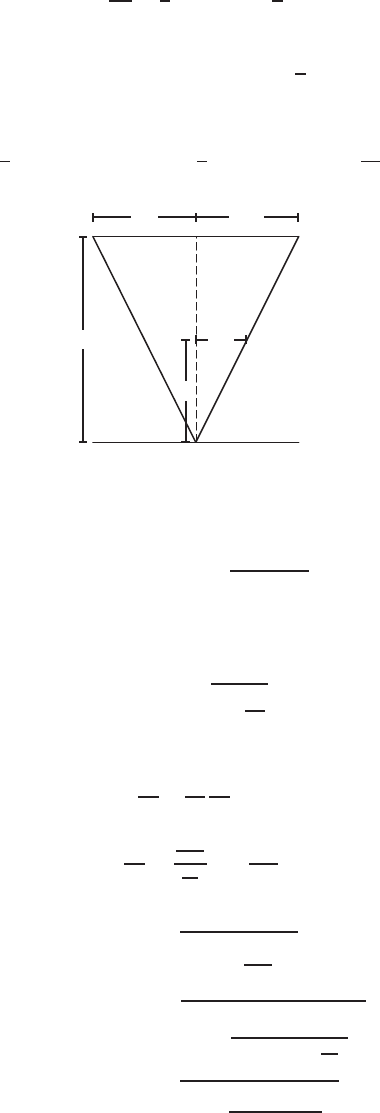
822 Chapter Eight /SOLUTIONS
19. We slice the tank horizontally. There is an outside radius rout and an inside radius rin and, at height h,
Volume of a slice ≈π(rout)2∆h−π(rin)2∆h.
See Figure 8.148. We see that rout = 3 for every slice. We use similar triangles to find rin in terms of the height h:
rin
h=3
6so rin =1
2h.
At height h,
Volume of slice ≈π(3)2∆h−π1
2h2
∆h.
To find the total volume, we integrate this quantity from h= 0 to h= 6.
V=Z6
0π(3)2−π1
2h2dh =πZ6
09−1
4h2dh =π9h−h3
12
6
0
= 36π= 113.097 m3.
✻
❄
6
m
✲✛ 3
m
✲✛ rout
✲✛
rin
✻
❄
h
Figure 8.148
20. Since f(x) = sin x,f′(x) = cos(x), so
Arc Length =Zπ
0p1 + cos2x dx.
21. We’ll find the arc length of the top half of the ellipse, and multiply that by 2. In the top half of the ellipse, the equation
(x2/a2) + (y2/b2) = 1 implies
y= +br1−x2
a2.
Differentiating (x2/a2) + (y2/b2) = 1 implicitly with respect to xgives us
2x
a2+2y
b2
dy
dx = 0,
so
dy
dx =−2x
a2
2y
b2
=−b2x
a2y.
Substituting this into the arc length formula, we get
Arc Length =Za
−as1 + −b2x
a2y2
dx
=Za
−av
u
u
t1 + b4x2
a4(b2)(1 −x2
a2)!dx
=Za
−as1 + b2x2
a2(a2−x2)dx.
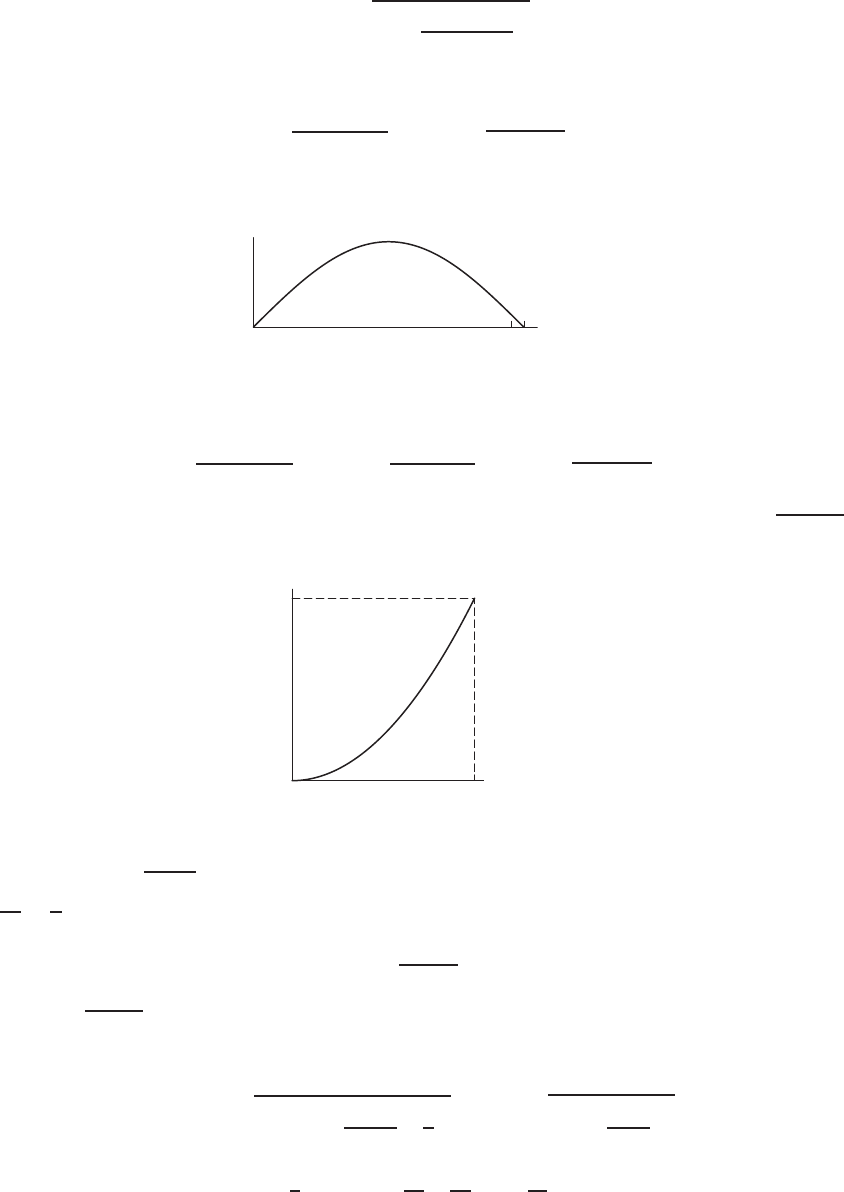
SOLUTIONS to Review Problems for Chapter Eight 823
Hence the arc length of the entire ellipse is
2Za
−as1 + b2x2
a2(a2−x2)dx.
22. Since f′(x) = cos x, we have
L=Z3
0p1 + (f′(x))2dx =Z3
0p1 + cos2x dx = 3.621.
We see in Figure 8.149 that the length of the curve is slightly longer than the length of the x-axis from x= 0 to x= 3,
so the answer of 3.621 makes sense.
3π
f(x) = sin x
x
Figure 8.149
23. Since f′(x) = 10x, we have
L=Z3
0p1 + (f′(x))2dx =Z3
0p1 + (10x)2dx =Z3
0p1 + 100x2dx = 45.230.
We see in Figure 8.150 that the length of the curve is definitely longer than 45 and slightly longer than √452+ 32=
45.10, so the answer of 45.230 is reasonable.
3
45 f(x) = 5x2
x
Figure 8.150
24. The arc length of √1−x2from x= 0 to x= 1 is one quarter of the perimeter of the unit circle. Hence the length is
2π
4=π
2.
25. The arc length is given by
L=Z2
1p1 + e2xdx ≈4.785.
Note that √1 + e2xdoes not have an obvious elementary antiderivative, so we use an approximation method to find an
approximate value for L.
26. The arc length is given by
L=Z2
1s1 + x4+1
(16x4)−1
2dx =Z2
1sx2+1
(4x2)2
dx
=Z2
1x2+1
4x−2dx =x3
3−1
4x
2
1
=59
24 .
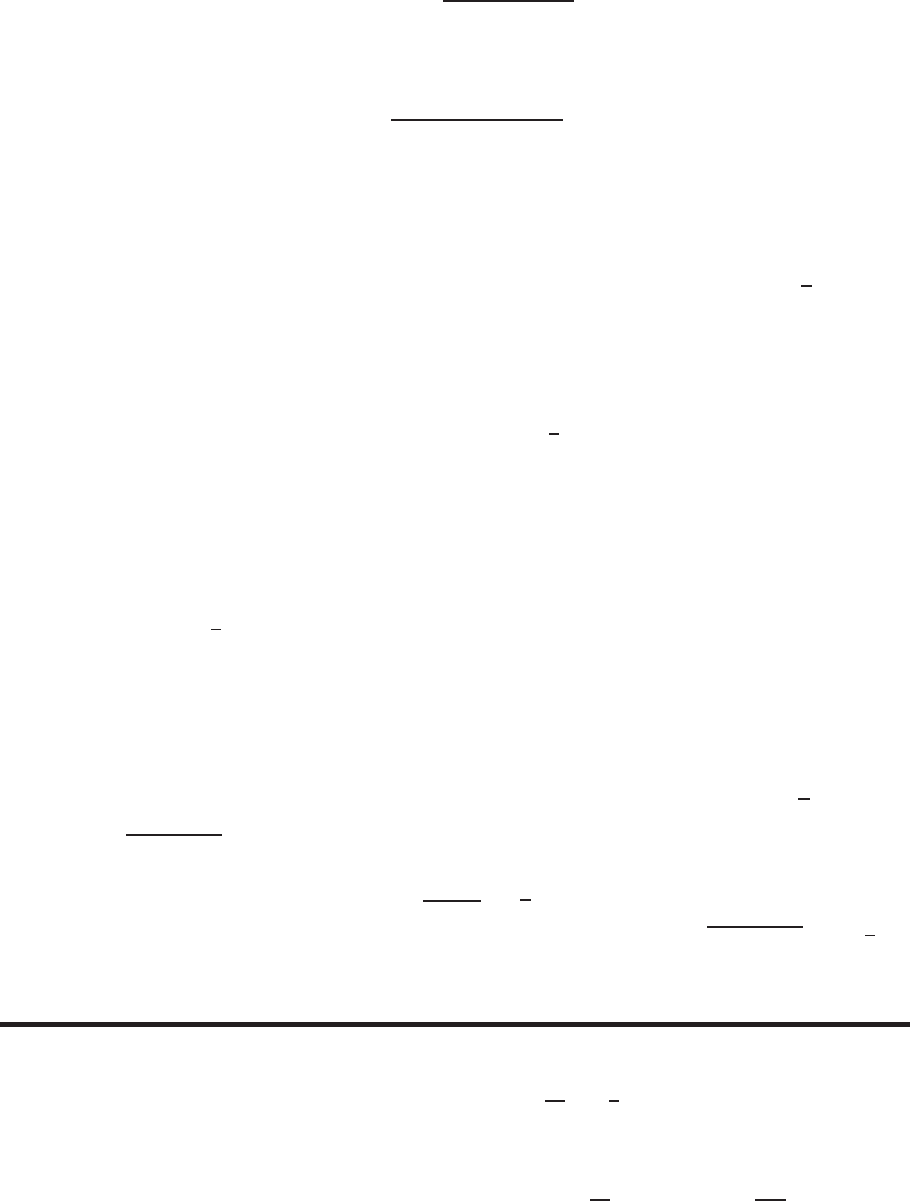
824 Chapter Eight /SOLUTIONS
27. We have dx/dt =−3 sin t,dy/dt = 2 cos t, so, evaluating the integral numerically, we have
Arc length =Z2π
0p9 cos2t+ 4 sin2t dt = 15.865.
The curve is a ellipse.
28. We have dx/dt =−2 sin(2t),dy/dt = 2 cos(2t), so, simplifying the integrand, we have
Arc length =Zπ
0p4 sin2(2t) + 4 cos2(2t)dt = 2 Zπ
0
dt = 2π.
The curve is a circle of radius 1.
29. •Z1
0
f(x)dxgives the area under the graph of ffrom 0 to 1.
•The graph of fis concave up and passes through the points (0,0) and (1,1), so it lies below the line y=x.
•The area under y=xfrom 0 to 1 is half the area of a square of side 1, or 1/2. Thus, Z1
0
f(x)dx < 1
2.
30. •Since f(0) = 0, the Fundamental Theorem gives Z0.5
0
f′(x)dx =f(0.5) −f(0) = f(0.5).
•The graph of fis concave up and passes through the points (0,0) and (1,1), so it lies below the line y=x. This
means f(x)< x for 0< x < 1.
•Since f(x)< x, we have f(0.5) <0.5. Hence Z0.5
0
f′(x)dx < 1
2.
31. •Since f(x) = xp, we know f−1(x) = x1/p, because (xp)1/p =x1/pp=x.
•Since f(0) = 0 and f(1) = 1, we know f−1(0) = 0 and f−1(1) = 1. Likewise, since fis increasing, so is f−1.
•Since p > 1, we know 0<1/p < 1, so the graph of f−1is concave down, and therefore lies above the line y=x
on 0< x < 1.
•Z1
0
f−1(x)dx gives the area under f−1from 0 to 1, so, since the graph lies above y=xon this interval, we have
Z1
0
f−1(x)dx > 1
2.
32. •Z1
0
π(f(x))2dx gives the volume of the region formed by rotating the graph of fon 0≤x≤1about the x-axis.
•The graph of fis concave up and contains (0,0) and (1,1), so it lies below the line y=xon 0< x < 1.
•This means the region formed by rotating the graph of flies within the region formed by rotating the line segment
y=x, which is a cone of base r= 1 and height h= 1. The volume of this cone is (1/3)πr2h=π/3.
•Since this cone contains the region formed by rotating the graph of f, we have Z1
0
π(f(x))2dx < π
3.
33. •Z1
0q1 + (f′(x))2dx gives the arc length of the graph of ffrom x= 0 to x= 1.
•The graph of fis concave up and contains (0,0) and (1,1), so it lies below the line y=xon 0< x < 1. The arc
length of the line between (0,0), and (1,1) is √12+ 12=√2.
•The line segment between (0,0) and (1,1) is shorter than the arc length of f, so Z1
0q1 + (f′(x))2dx > √2.
Problems
34. (a) The points of intersection are x= 0 to x= 2, so we have
Area =Z2
0
(2x−x2)dx =x2−x3
3
2
0
=4
3= 1.333.
(b) The outside radius is 2xand the inside radius is x2, so we have
Volume =Z2
0
(π(2x)2−π(x2)2)dx =πZ2
0
(4x2−x4)dx =π
15 (20x3−3x5)
2
0
=64π
15 = 13.404.
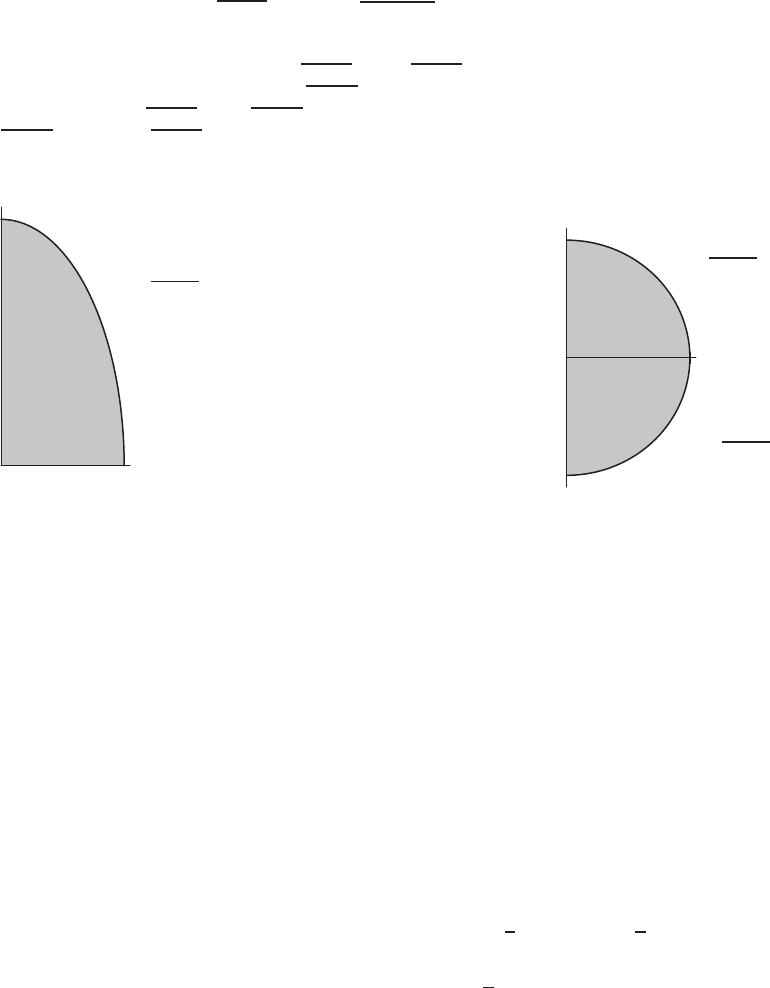
SOLUTIONS to Review Problems for Chapter Eight 825
(c) The length of the perimeter is equal to the length of the top plus the length of the bottom. Using the arclength formula,
and the fact that the derivative of 2xis 2and the derivative of x2is 2x, we have
L=Z2
0p1 + 22dx +Z2
0p1 + (2x)2dx = 4.4721 + 4.6468 = 9.119.
35. There are at least two possible answers. Since √4−x2−(−√4−x2)≥0when 0≤x≤2,one possibility is that the
integral gives the area between the curve y= 2√4−x2and the line y= 0 as shown in Figure 8.151.
Alternatively, since √4−x2≥ −√4−x2when 0≤x≤2,the integral gives the area between the quarter circles
y=√4−x2and y=−√4−x2, as shown in Figure 8.152.
2
4
y= 2√4−x2
x
y
Figure 8.151
2
−2
2
y=√4−x2
y=−√4−x2
x
y
Figure 8.152
36. The two functions intersect at (0,0) and (5,25). We slice the volume with planes perpendicular to the horizontal line
y= 30. This divides the solid into thin washers with volume
Volume of slice =π((rout)2−(rin)2)∆x.
The outer radius is the vertical distance from the line y= 30 to the curve y=x2, so rout = 30 −x2. Similarly, the inner
radius is the vertical distance from the line y= 30 to the curve y= 5x, so rin = 30 −5x. Integrating from x= 0 to
x= 5 we have
V=Z5
0
π((30 −x2)2−(30 −5x)2)dx.
37. The two functions intersect at (0,0) and (5,25). We slice the volume with planes perpendicular to the vertical line x= 8.
This divides the solid into thin washers with volume
Volume of slice =π((rout)2−(rin)2)∆y.
The outer radius is the horizontal distance from the line x= 8 to the curve x=y/5, so rout = 8 −y/5. Similarly, the
inner radius is the horizontal distance from the line x= 8 to the curve x=√y, so rin = 8 −√y. Integrating from y= 0
to y= 25 we have
V=Z25
0
π((8 −y/5)2−(8 −√y)2)dy.
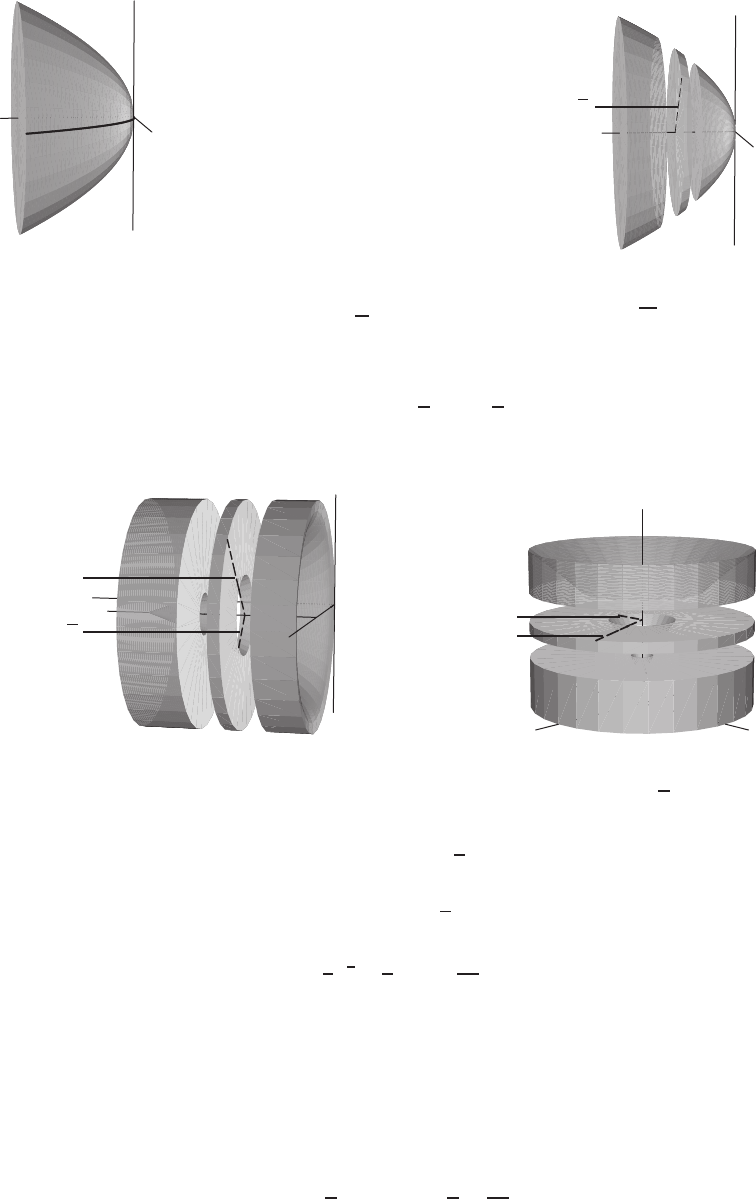
826 Chapter Eight /SOLUTIONS
38. (a) See Figure 8.153
x
y
Figure 8.153
: Rotated
Region
x
y
✲
r=√x
Figure 8.154
: Cutaway View
(b) Divide [0,1] into Nsubintervals of width ∆x=1
N. The volume of the ith disc is π(√xi)2∆x=πxi∆x. So,
V≈PN
i=1 πxi∆x. See Figure 8.154
(c)
Volume =Z1
0
πx dx =π
2x2
1
0
=π
2≈1.57.
39. (a) See Figure 8.155.
x
y
z
(
y= 1
)
rout = 1 ✲
rin = 1 −√x✲
Figure 8.155
xy
z
✲
rout = 1
✲
rin =y2
Figure 8.156
Slice the figure perpendicular to the x–axis. One gets washers of inner radius 1−√xand outer radius 1.
Therefore,
V=Z1
0π12−π(1−√x)2dx
=πZ1
0
(1 −[1 −2√x+x]) dx
=πh4
3x3
2−1
2x2i1
0
=5π
6≈2.62.
(b) See Figure 8.156. Note that x=y2. We now integrate over yinstead of x, slicing perpendicular to the y–axis. This
gives us washers of inner radius xand outer radius 1. So
V=Zy=1
y=0
(π12−πx2)dy
=Z1
0
π(1−y4)dy
=πy −π
5y5
1
0
=π−π
5=4π
5≈2.51.
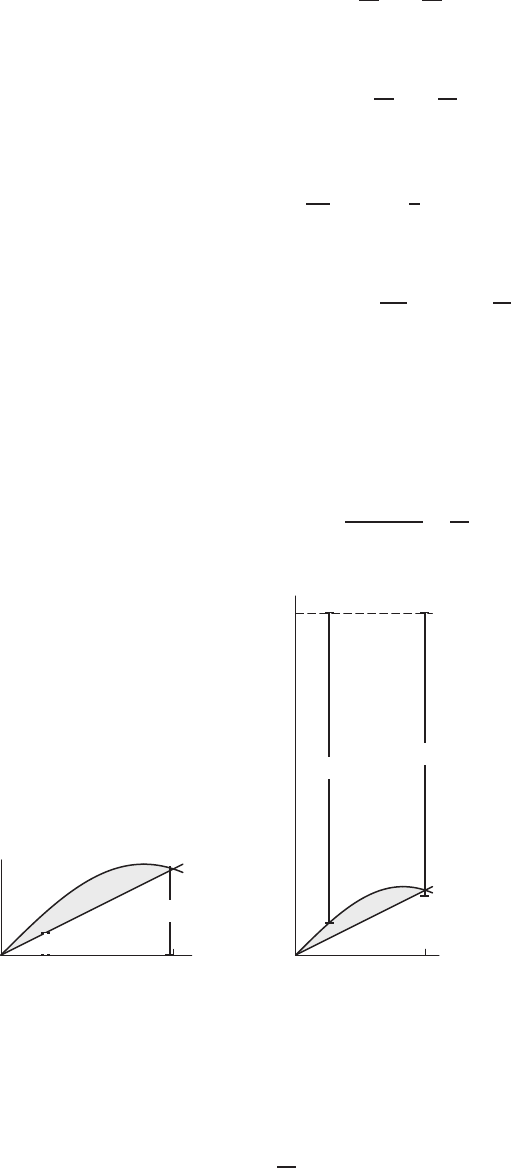
SOLUTIONS to Review Problems for Chapter Eight 827
40. (a) Since y=ax2is non-negative, we integrate to find the area:
Area =Z2
0
(ax2)dx =ax3
3
2
0
=8a
3.
(b) Each slice of the object is approximately a cylinder with radius ax2and thickness ∆x. We have
Volume =Z2
0
π(ax2)2dx =πa2x5
5
2
0
=32
5a2π.
41. (a) Since y=e−bx is non-negative, we integrate to find the area:
Area =Z1
0
(e−bx)dx =−1
be−bx
1
0
=1
b(1 −e−b).
(b) Each slice of the object is approximately a cylinder with radius e−bx and thickness ∆x. We have
Volume =Z1
0
π(e−bx)2dx =πZ1
0
e−2bxdx =−π
2be−2bx
1
0
=π
2b(1 −e−2b).
42. (a) We divide the region into vertical strips of thickness ∆x. As a slice is rotated about the x-axis, it creates a disk
of radius rout from which has been removed a smaller circular disk of radius rin. We see in Figure 8.157 that
rout = sin xand rin = 0.5x. Thus,
Volume of a slice ≈π(rout)2∆x−π(rin)2∆x=π(sin x)2∆x−π(0.5x)2∆x.
To find the total volume, we integrate this quantity between the points of intersection x= 0 and x= 1.9:
V=Z1.9
0
(π(sin x)2−π(0.5x)2)dx =π−sin xcos x
2−x3
12 +x
1.9
0
= 1.669.
1.9
y= 0.5x
y= sin x
✻
❄
rout = sin x
✻
❄
rin = 0.5xx
y
Figure 8.157
1.9
5
y= 0.5x
y= sin x
✻
❄
rmout = 5 −0.5x
✻
❄
rmin = 5 −sin x
x
y
Figure 8.158
(b) We see in Figure 8.158 that rout = 5 −0.5xand rin = 5 −sin x. Thus,
Volume of a slice ≈π(rout)2∆x−π(rin)2∆x=π(5 −0.5x)2∆x−π(5 −sin x)2∆x.
To find the total volume, V, we integrate this quantity between the points of intersection x= 0 and x= 1.9:
V=Z1.9
0
(π(5−0.5x)2−π(5 −sin x)2)dx =π
12 (6(sin x−20) cos x+x(x2−30x−6))
1.9
0
= 11.550.
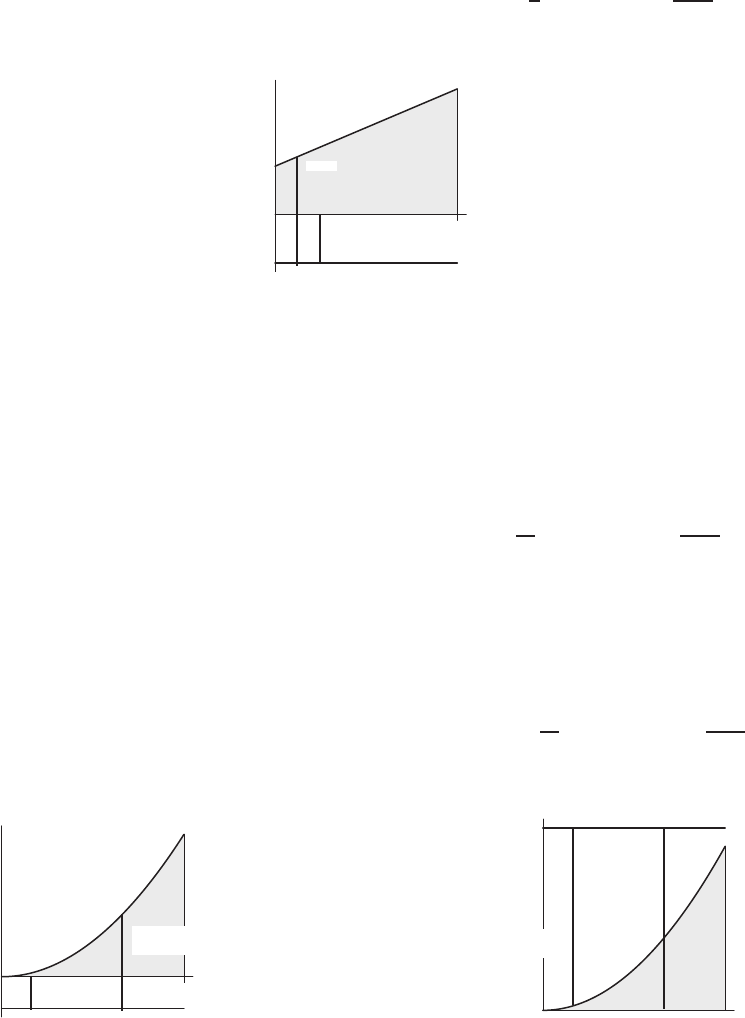
828 Chapter Eight /SOLUTIONS
43. We divide the region into vertical strips of thickness ∆x. As a slice is rotated about the x-axis, it creates a disk of radius
rout from which has been removed a disk of radius rin. We see in Figure 8.159 that rout = 5 + 2xand rin = 5. Thus,
Volume of a slice ≈π(rout)2∆x−π(rin)2∆x=π(5 + 2x)2∆x−π(5)2∆x.
To find the total volume, V, we integrate this quantity between x= 0 and x= 4:
V=Z4
0
(π(5 + 2x)2−π(5)2)dx =πZ4
0
((5 + 2x)2−25) dx =π4
3x3+ 10x2
4
0
=736π
3= 770.737.
4
−5
5rout
✻
rin = 5
✻
y=−5
y= 5 + 2x
x
y
Figure 8.159
44. (a) We divide the region into vertical strips of thickness ∆x. As a slice is rotated about the x-axis, it creates a disk of
radius rout from which has been removed a disk of radius rin. We see in Figure 8.160 that rout = 2+x2and rin = 2.
Thus,
Volume of a slice ≈π(rout)2∆x−π(rin)2∆x=π(2 + x2)2∆x−π(2)2∆x.
To find the total volume, V, we integrate this quantity between x= 0 and x= 3:
V=Z3
0
(π(2 + x2)2−π(2)2)dx =πZ3
0
((2 + x2)2−4) dx =π
15 (3x5+ 20x3)
3
0
=423π
5= 265.778.
(b) We see in Figure 8.161 that rout = 10 and rin = 10 −x2. Thus,
Volume of a slice ≈π(rout)2∆x−π(rin)2∆x=π(10)2∆x−π(10 −x2)2∆x.
To find the total volume, V, we integrate this quantity between x= 0 and x= 3:
V=Z3
0
(π(10)2−π(10 −x2)2)dx =πZ3
0
(100 −(10 −x2)2)dx =π
15 (100x3−3x5)
3
0
=657π
5= 412.805.
3
✻
rout = 2 + x2
✻
rin = 2 y=−2
y=x2
x
y
Figure 8.160
3
10
rout = 10
✻
rin = 10 −x2
✻y= 10
y=x2
x
y
Figure 8.161
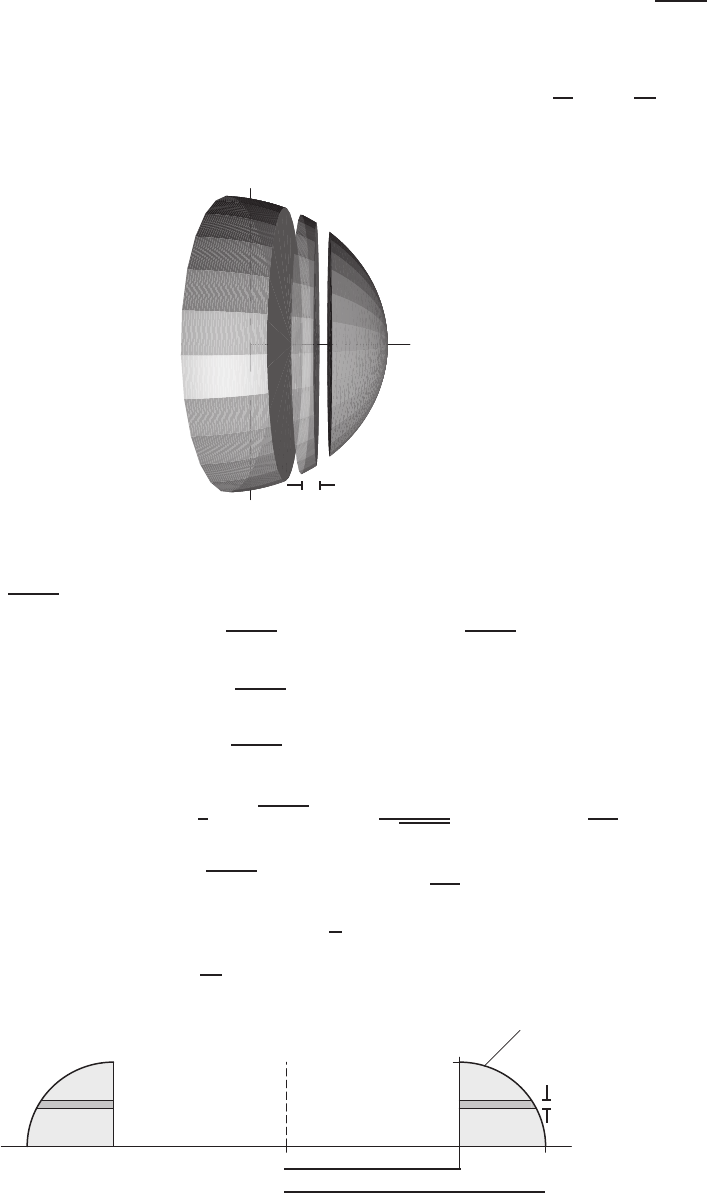
SOLUTIONS to Review Problems for Chapter Eight 829
45. Slice the object into disks vertically, as in Figure 8.162. A typical disk has thickness ∆xand radius y=√1−x2. Thus
Volume of disk ≈πy2∆x=π(1 −x2) ∆x.
Volume of solid = lim
∆x→0Xπ(1−x2) ∆x=Z1
0
π(1 −x2)dx =πx−x3
3
1
0
=2π
3.
Note: As we expect, this is the volume of a half sphere.
x
1
✲ ✛
∆x
y
1
Figure 8.162
46. Slice the object into rings horizontally, as in Figure 8.163. A typical ring has thickness ∆y, inner radius 2 and outer radius
2 + x= 2 + p1−y2. Thus,
Volume of ring ≈π(2 + p1−y2)2∆y−π22∆y=π(4p1−y2+ 1 −y2) ∆y.
Volume of solid =Z1
0
π(4p1−y2+ 1 −y2)dy
= 4πZ1
0p1−y2dy +πZ1
0
1dy−πZ1
0
y2dy
= 4π 1
2 yp1−y2
1
0
+Z1
0
1
p1−y2dy!!+πy
1
0−πy3
3
1
0
= 2πyp1−y2+ 2πarcsin y+πy −πy3
3
1
0
=0 + 2πarcsin 1 + π−π
3−0−2πarcsin 0 −0 + 0
=π2+2π
3= 11.964.
−21
1
✻
❄
∆y
Inner radius
✲
Outer radius
✲
Axis
x=−2✠
x2+y2= 1
x
y
Figure 8.163
: Cross-section of solid

830 Chapter Eight /SOLUTIONS
47. Slice the object into rings horizontally, as in Figure 8.164. A typical ring has thickness ∆y, outer radius 1, and inner radius
1−x= 1 −p1−y2. Thus,
Volume of ring ≈π12∆y−π(1 −p1−y2)2∆y=π(2p1−y2−(1 −y2)) ∆y.
Volume of solid =Z1
0
π(2p1−y2−1 + y2)dy
= 2πZ1
0p1−y2dy −πZ1
0
1dy +πZ1
0
y2dy
= 2π·1
2 yp1−y2
1
0
+ 12Z1
0
1
p1−y2dy!−πy
1
0
+πy3
3
1
0
=πyp1−y2+πarcsin y−πy +πy3
3
1
0
= 0 + π2
2−π+π
3−0−0 + 0 −0
=π2
2−2π
3= 2.840.
21
1
✻
❄
∆y
❄
Inner radius
✛✛
❄
Outer radius
Axis
x
y
Figure 8.164
: Cross-section of solid
48. Slicing perpendicularly to the x-axis gives squares whose thickness is ∆xand whose side is y=√1−x2. See Fig-
ure 8.165. Thus,
Volume of square slice ≈(p1−x2)2∆x= (1 −x2) ∆x.
Volume of solid =Z1
0
(1 −x2)dx =x−x3
3
1
0
=2
3.
1
1
✻
❄
∆y
✲ ✛
Delta x
✠
Base of square (standing on paper)
✠
x2+y2= 1
x
y
Figure 8.165
: Base of solid
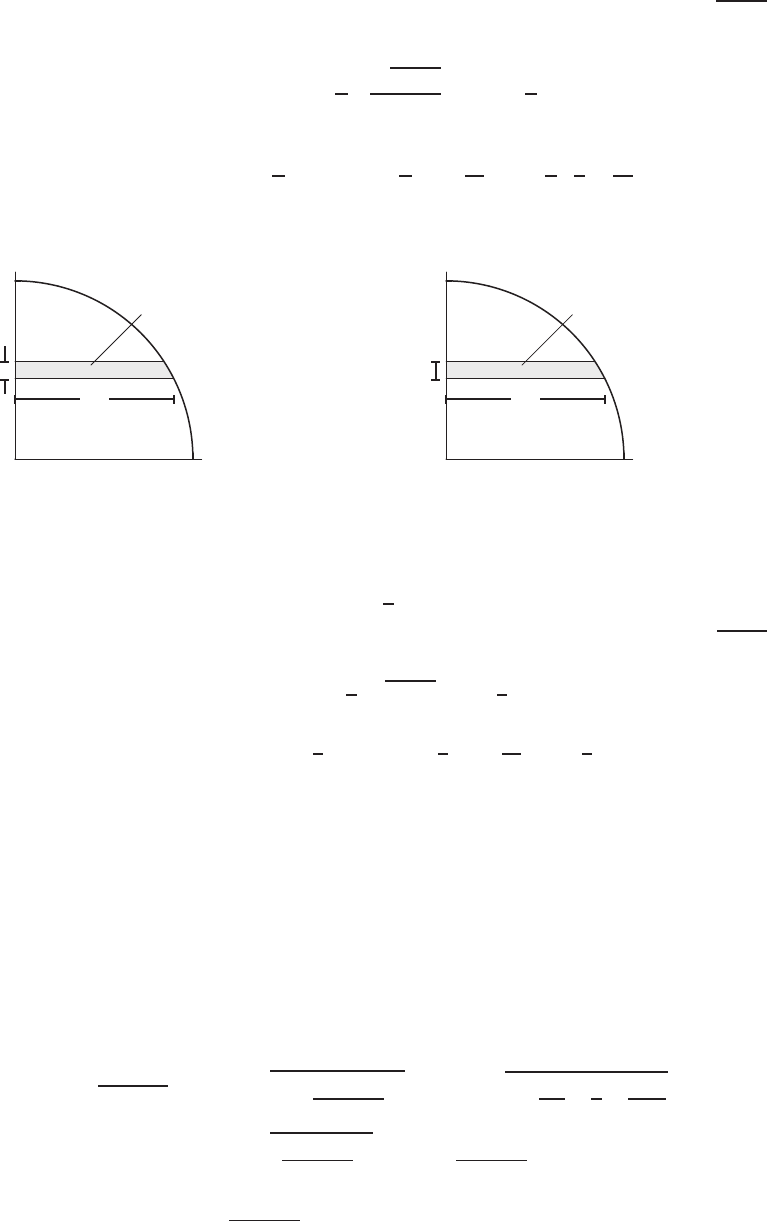
SOLUTIONS to Review Problems for Chapter Eight 831
49. Slicing perpendicularly to the y-axis gives semicircles whose thickness is ∆yand whose diameter is x=p1−y2. See
Figure 8.166. Thus
Volume of semicircular slice ≈π
2 p1−y2
2!2
∆y=π
8(1 −y2) ∆y.
Volume of solid =Z1
0
π
8(1 −y2)dy =π
8y−y3
3
1
0
=π
8·2
3=π
24 .
1
1
✻
❄
∆y
✲✛ ∆x
✠
Diameter of semicircle (standing on paper)
x
y
Figure 8.166
: Base of Solid
1
1
✻
❄
∆y
✲✛ ∆x
✠
Leg of isosceles triangle (standing on paper)
x
y
Figure 8.167
: Base of solid
50. An isosceles triangle with legs of length shas
Area =1
2s2.
Slicing perpendicularly to the y-axis gives isosceles triangles whose thickness is ∆yand whose leg is x=p1−y2. See
Figure 8.167. Thus
Volume of triangular slice ≈1
2(p1−y2) ∆y=1
2(1 −y2) ∆y.
Volume of solid =Z1
0
1
2(1 −y2)dy =1
2y−y3
3
1
0
=1
3.
51. The curve y=x(x−3)2has x-intercepts at x= 0,3and lies above the x-axis on this interval.
Thus, Z3
0
x(x−3)2dx gives the area under the graph of ffrom x= 0 to x= 3.
52. The curve y=x(x−3)2has x-intercepts at x= 0,3and lies above the x-axis on this interval. Rotating the curve about
the x-axis forms a solid of revolution with
Volume =Z3
0
π(f(x))2dx =Z3
0
πx(x−3)22dx =Z3
0
πx2(x−3)4dx.
Thus, this expression represents a volume of revolution about the x-axis between x= 0 and x= 3.
53. Since y= (ex+e−x)/2,y′= (ex−e−x)/2. The length of the catenary is
Z1
−1p1 + (y′)2dx =Z1
−1r1 + hex−e−x
2i2
dx =Z1
−1r1 + e2x
4−1
2+e−2x
4dx
=Z1
−1rhex+e−x
2i2
dx=Z1
−1
ex+e−x
2dx
=ex−e−x
2
1
−1
=e−e−1.

832 Chapter Eight /SOLUTIONS
54. (a) Slice the headlight into Ndisks of height ∆xby cutting perpendicular to the x–axis. The radius of each disk is y;
the height is ∆x. The volume of each disk is πy2∆x. Therefore, the Riemann sum approximating the volume of the
headlight is
N
X
i=1
πy2
i∆x=
N
X
i=1
π9xi
4∆x.
(b)
πZ4
0
9x
4dx =π9
8x2
4
0
= 18π.
55. (a) The line y=ax must pass through (l, b). Hence b=al, so a=b/l.
(b) Cut the cone into Nslices, slicing perpendicular to the x–axis. Each piece is almost a cylinder. The radius of the ith
cylinder is r(xi) = bxi
l, so the volume
V≈
N
X
i=1
πbxi
l2
∆x.
Therefore, as N→ ∞, we get
V=Zl
0
πb2l−2x2dx
=πb2
l2x3
3l
0
=πb2
l2l3
3=1
3πb2l.
56. (a) If you slice the apple perpendicular to the core, you expect that the cross section will be approximately a circle.
1
1.5
h
H
f(h)
If f(h)is the radius of the apple at height habove the bottom, and His the height of the apple, then
Volume =ZH
0
πf(h)2dh.
Ignoring the stem, H≈3.5. Although we do not have a formula for f(h), we can estimate it at various points.
(Remember, we measure here from the bottom of the apple, which is not quite the bottom of the graph.)
h0 0.5 1 1.5 2 2.5 3 3.5
f(h)1 1.5 2 2.1 2.3 2.2 1.8 1.2
Now let g(h) = πf (h)2, the area of the cross-section at height h. From our approximations above, we get the
following table.
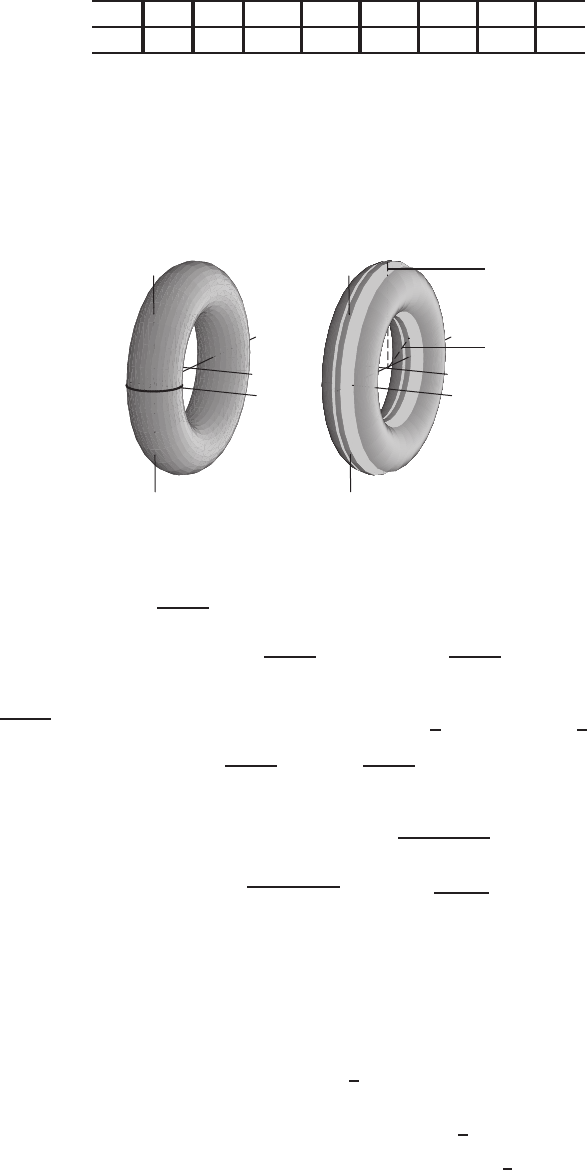
SOLUTIONS to Review Problems for Chapter Eight 833
h0 0.5 1 1.5 2 2.5 3 3.5
g(h) 3.14 7.07 12.57 13.85 16.62 13.85 10.18 4.52
We can now take left- and right-hand sum approximations. Note that ∆h= 0.5inches. Thus
LEFT(9) = (3.14 + 7.07 + 12.57 + 13.85 + 16.62 + 13.85 + 10.18)(0.5) = 38.64.
RIGHT(9) = (7.07 + 12.57 + 13.85 + 16.62 + 13.85 + 10.18 + 4.52)(0.5) = 39.33.
Thus the volume of the apple is ≈39 cu.in.
(b) The apple weighs 0.03 ×39 ≈1.17 pounds, so it costs about 94c/.
57.
x
y
z
(
y= 3
)
Figure 8.168
: The Torus
x
y
z
(
y= 3
)
rin = 3 −y
✛
rout = 3 + y
✛
Figure 8.169
: Slice of Torus
As shown in Figure 8.169, we slice the torus perpendicular to the line y= 3. We obtain washers with width dx, inner
radius rin = 3 −y, and outer radius rout = 3 + y. Therefore, the area of the washer is πr2
out −πr2
in =π[(3 + y)2−
(3 −y)2] = 12πy. Since y=√1−x2, the volume is gotten by summing up the volumes of the washers: we get
Z1
−1
12πp1−x2dx = 12πZ1
−1p1−x2dx.
But R1
−1√1−x2dx is the area of a semicircle of radius 1, which is π
2. So we get 12π·π
2= 6π2≈59.22. (Or, you
could use Zp1−x2dx =hxp1−x2+ arcsin(x)i,
by VI-30 and VI-28.)
58. The arc length of the curve y=f(t)from t= 3 to t= 8 is R8
3p1 + (f′(t))2dt. Thus, we want a function fsuch that
Z8
3q1 + (f′(t))2dt =Z8
3p1 + e6tdt.
Thus, we have f′(t)2=e6t.
One possibility is
f′(t) = e3t
f(t) = 1
3e3t+C.
For any constant C, the original integral is the arc length of the curve y=1
3e3t+Cfrom t= 3 to t= 8.
Another solution to f′(t)2=e6tisf′(t) = −e3t, which gives f(t) = −1
3e3t+C.

834 Chapter Eight /SOLUTIONS
59. We take a cross-section of the pipe and cut it up in such a way that the speed of the water is nearly uniform on each slice.
See Figure 8.170.
We use thin rings around the pipe’s center; if a given ring is narrow enough, all points on it will be roughly equidistant
from the center. Since the water speed is a function of the distance from the center, the speed is nearly constant on the
entire ring.
Let rbe the distance from the center to the inner boundary of the ring, and let ∆rbe the width of the ring, as in
Figure 8.170. By straightening the ring into a thin rectangle, we find that its area is approximately given by the quantity
2πr∆r. The speed across any part of the ring is roughly equal to the speed across the inner boundary, 10(1 −r2)inches
per second. The flow is defined as the speed times the area; thus on any given ring we have
Flow ≈10(1 −r2)·2πr∆r.
The total flow across the pipe cross-section is approximated by a Riemann sum incorporating all of the rings:
Total Flow ≈20πX(1 −r2)r∆r,
where ris in between 0 and 1. Letting ∆r→0, we obtain the exact solution:
Total Flow = 20πZ1
0
(1−r2)r dr = 20πr2
2−r4
4
1
0
= 5πcubic inches/second.
1
r
∆r
Figure 8.170
60. Multiplying r= 2acos θby r, converting to Cartesian coordinates, and completing the square gives
r2= 2ar cos θ
x2+y2= 2ax
x2−2ax +a2+y2=a2
(x−a)2+y2=a2.
This is the standard form of the equation of a circle with radius aand center (x, y) = (a, 0).
To check the limits on θnote that the circle is in the right half plane, where −π/2≤θ≤π/2. Rays from the origin
at all these angles meet the circle because the circle is tangent to the y-axis at the origin.
61. The area is given by
Zπ/2
−π/2
1
2r2dθ =Zπ/2
−π/2
1
2(2acos θ)2dθ = 2a2Zπ/2
−π/2
cos2θ dθ = 2a21
2cos θsin θ+θ
2
π/2
−π/2
=πa2.
(We have used formula IV-18 from the integral table. The integral can also be done using a calculator or integration by
parts.)
62. See Figure 8.171. The circles meet where
2acos θ=a
cos θ=1
2
θ=±π
3.
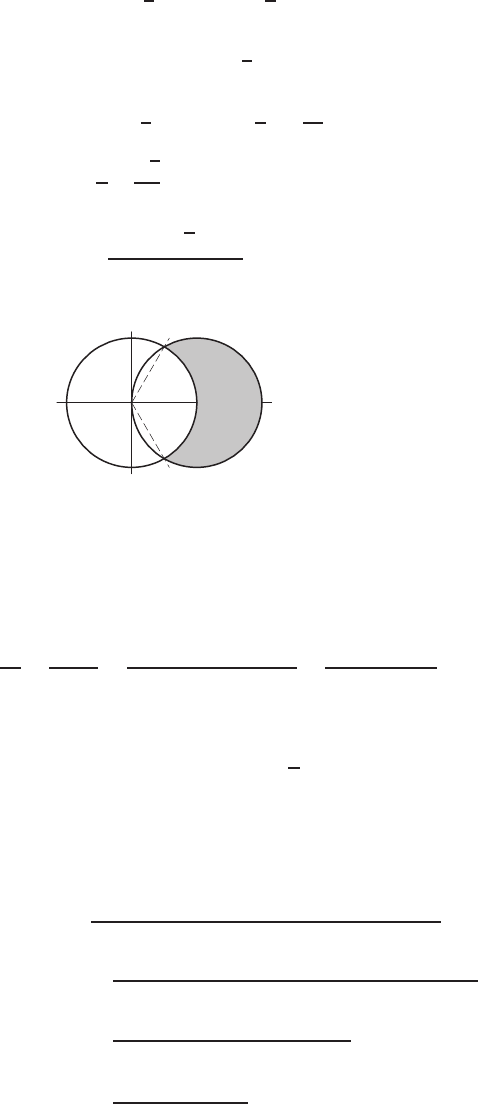
SOLUTIONS to Review Problems for Chapter Eight 835
The area is obtained by subtraction:
Area =Zπ/3
−π/31
2(2acos θ)2−1
2a2dθ
=Zπ/3
−π/32a2cos2θ−1
2a2dθ
=2a21
2cos θsin θ+θ
2−a2
2θ
π/3
−π/3
=π
3+√3
2a2.
Since π/3 + √3/2a2
πa2= 61%
the shaded region covers 61% of circle C.
a
C
r= 2acos θ
π/3
−π/3
r=a
x
y
Figure 8.171
63. (a) Writing Cin parametric form gives
x= 2acos2θand y= 2acos θsin θ,
so the slope is given by
dy
dx =dy/dθ
dx/dθ =−2asin2θ+ 2acos2θ
−4acos θsin θ=sin2θ−cos2θ
2 cos θsin θ.
(b) The maximum y-value occurs where dy/dx = 0, so
sin2θ−cos2θ= 0
θ=±π
4.
The value θ=π/4gives the maximum y-value; θ=−π/4gives the minimum y-value.
64. Writing Cin parametric form gives
x= 2acos2θand y= 2acos θsin θ,
so
Arc length =Zπ/2
−π/2p(−4acos θsin θ)2+ (−2asin2θ+ 2acos2θ)2dθ
= 2aZπ/2
−π/2p4 cos2θsin2θ+ sin4θ−2 sin2θcos2θ+ cos4θ dθ
= 2aZπ/2
−π/2psin4θ+ 2 sin2θcos2θ+ cos4θ dθ
= 2aZπ/2
−π/2p(sin2θ+ cos2θ)2dθ
= 2aZπ/2
−π/2
dθ = 2πa.
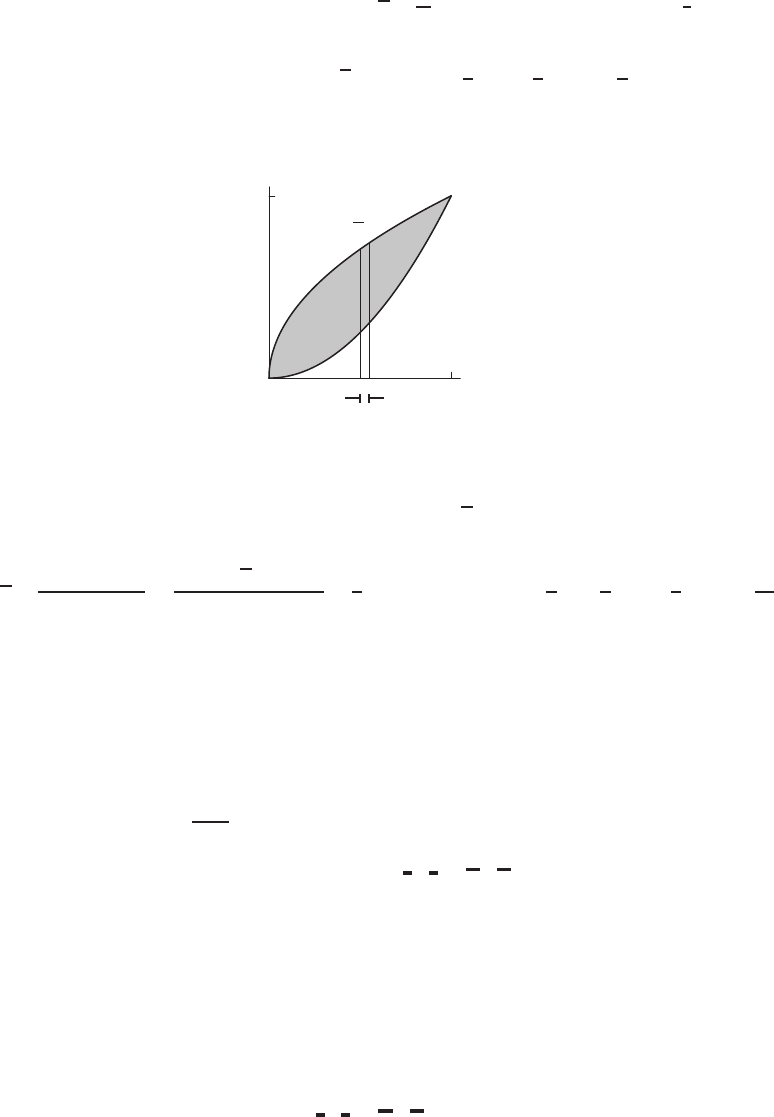
836 Chapter Eight /SOLUTIONS
65. This function has zeros at x=−2and x= 1. The bounded region lies between these two zeros. Thus,
Volume =Z1
−2
π(x−1)2(x+ 2)2dx.
66. The total mass is 12 gm, so the center of mass is located at x=1
12 (−5·3−3·3 + 2 ·3 + 7 ·3) = 1
4.
67. (a) Since the density is constant, the mass is the product of the area of the plate and its density.
Area of the plate =Z1
0
(√x−x2)dx =2
3x3/2−1
3x3
1
0
=1
3cm2.
Thus the mass of the plate is 2·1/3 = 2/3gm.
(b) See Figure 8.172. Since the region is “fatter” closer to the origin, ¯xis less than 1/2.
✲ ✛
∆x
1
1
y=√xy=x2
x
y
Figure 8.172
(c) To find ¯x, we slice the region into vertical strips of width ∆x. See Figure 8.172.
Area of strip =Ax(x)∆x≈(√x−x2)∆xcm2.
Then we have
x=RxδAx(x)dx
Mass =R1
02x(√x−x2)dx
2/3=3
2Z1
0
2(x3/2−x3)dx =3
2·22
5x5/2−1
4x4
1
0
=9
20 cm.
This is less than 1/2, as predicted in part (b). So ¯x= ¯y= 9/20 cm.
68. Let xbe the height from ground to the weight. It follows that 0≤x≤20. At height x, to lift the weight ∆xmore, the
work needed is 200∆x+ 2(20 −x)∆x= (240 −2x)∆x. So the total work is
W=Z20
0
(240 −2x)dx = (240x−x2)
20
0
= 240(20) −202= 4400 ft-lb.
69. Imagine the pole is divided into nsegments of length ∆x. The heights of the segments are given by x1, x2,...,xi,...xn.
A segment of length ∆xweighs 20 lb
10 ft ·∆x= 2∆x. The work required to raise a segment a vertical distance of xift is
Work to raise segment xift =Weight
|{z}
2∆x
·Distance
| {z }
xi
= 2xi∆x.
The total work is therefore
Total work = lim
n→∞
n
X
i=1
2xi∆x
=Z10
0
2x dx =x2
10
0
=100 ft-lbs.
To check our answer, notice that the work required to raise the entire 20 lb pole so that it is suspended horizontally 10 ft
above the ground is:
Work =Weight
|{z}
20 lbs
·Distance
| {z }
10 ft
=200 ft-lbs.
This is more than 100 lbs, because it should take more work to raise the entire pole 10 ft than to stand it upright.

SOLUTIONS to Review Problems for Chapter Eight 837
70. Let xbe the distance from the bucket to the surface of the water. It follows that 0≤x≤40. At xfeet, the bucket weighs
(30 −1
4x), where the 1
4xterm is due to the leak. When the bucket is xfeet from the surface of the water, the work done
by raising it ∆xfeet is (30 −1
4x) ∆x. So the total work required to raise the bucket to the top is
W=Z40
0
(30 −1
4x)dx
=30x−1
8x2
40
0
= 30(40) −1
8402= 1000 ft-lb.
71. Consider lifting a rectangular slab of water hfeet from the top up to the top. See Figure 8.173. The area of such a slab is
(10)(20) = 200 square feet; if the thickness is ∆h, then the volume of such a slab is 200 ∆hcubic feet. This much water
weighs 62.4 pounds per ft3, so the weight of such a slab is (200 ∆h)(62.4) = 12480 ∆hpounds. To lift that much water
hfeet requires 12480h∆hfoot-pounds of work. To lift the whole tank, we lift one plate at a time; integrating over the
slabs yields
Z15
0
12480h dh =12480h2
2
15
0
=12480 ·152
2= 1,404,000 foot-pounds.
10
20
15
h
∆h
Figure 8.173
72. We begin by slicing the oil into slabs at a distance hbelow the surface with thickness ∆h. We can then calculate the
volume of the slab and the work needed to raise this slab to the surface, a distance of h.
Volume of ∆hdisk =πr2∆h= 25π∆h
Weight of ∆hdisk = (25π)(50)∆h
Distance to raise =h
Work to raise = (25π)(50)(h)∆h.
Integrating the work over all such slabs, we have
Work =Z25
19
(50)(25π)(h)dh
= 625πh2
25
19
= 390,625π−225,625π
≈518,363 ft-lbs.
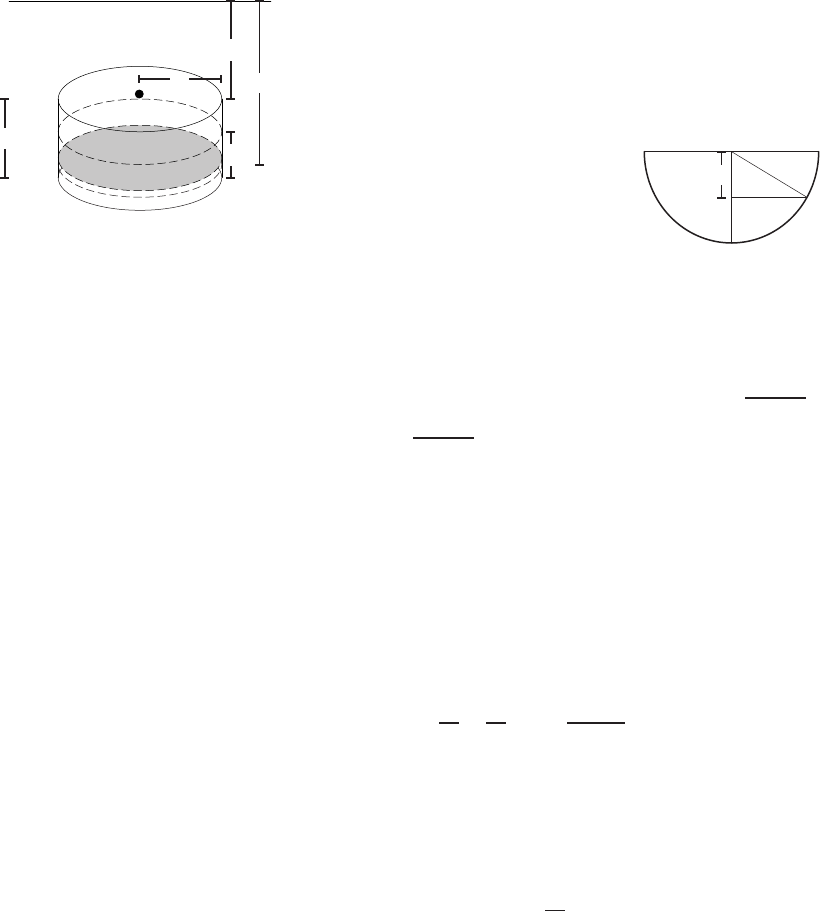
838 Chapter Eight /SOLUTIONS
A diagram of this tank is shown in Figure 8.174.
✻
❄
15′
∆h
✻
❄
6′
✻
❄
10′
✻
❄
h
✲✛ 5′
Figure 8.174
5
r
✻
❄
h
Figure 8.175
73. We slice the gasoline horizontally. At a distance hfeet below the surface, the horizontal slab is a cylinder with radius r
and thickness ∆h, so
Volume of one slab ≈πr2∆h.
To find the radius rat a depth hfrom the top as in Figure 8.175, we note that h2+r2= 52, so r=√25 −h2. At depth
h
Volume of one slice ≈π(p25 −h2)2∆h=π(25 −h2)∆hft3.
The gasoline at depth hmust be lifted a distance of hft, so
Work to move one slice =ρ·Volume ·Distance lifted
≈ρ(π(25 −h2)∆h)(h)ft-lb.
The work done, W, to lift all the gasoline is the sum of the work done on the pieces:
W≈Xρ(π(25 −h2)∆h)hft-lb..
As ∆h→0, we obtain a definite integral. Since hvaries from h= 0 to h= 5 and ρ= 42, we have:
W=Z5
0
ρπ(25h−h3)dh = 42π25 h2
2−h4
4
5
0
=13125π
2= 20,617 ft-lb.
The work to pump all the gasoline out is 20,617 ft-lbs.
74. Let hbe height above the bottom of the dam. Then
Water force =Z25
0
(62.4)(25 −h)(60) dh
= (62.4)(60) 25h−h2
2
25
0
=(62.4)(60)(625 −312.5)
= (62.4)(60)(312.5)
= 1,170,000 lbs.
75. If the weight of the chain were negligible, the work required would be 1000 ·20 = 20,000 ft-lbs. Because of the chain,
the total work is slightly more than 20,000 ft-lbs. When the object is hft off the ground, the length of chain is 50 −hso
the total weight being lifted is 1000 + 2(50 −h)lb. See Figure 8.176. Thus
Work to lift the weight an addition ∆hhigher =Weight ·Distance lifted
≈(1000 + 2(50 −h))∆hft-lb.
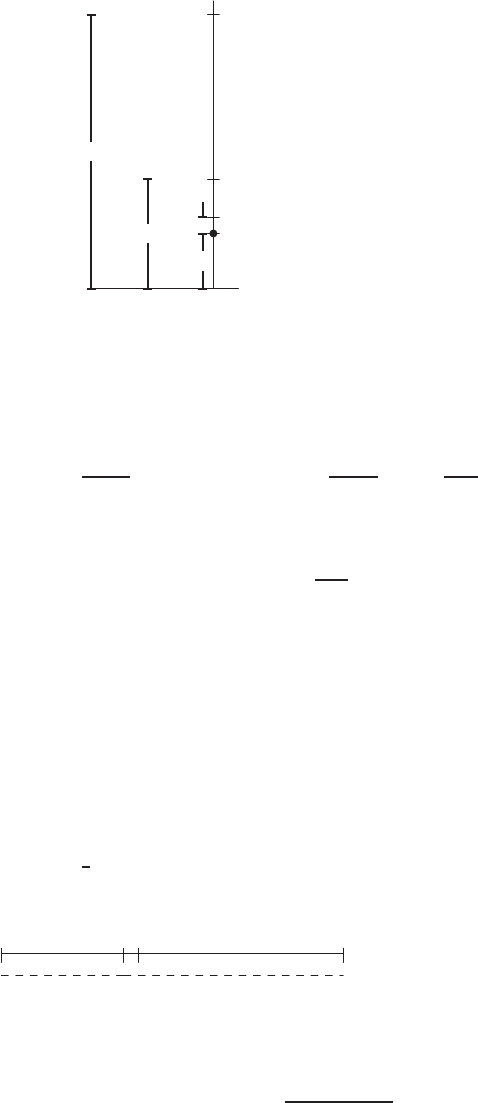
SOLUTIONS to Review Problems for Chapter Eight 839
To find the total work, we integrate this quantity from h= 0 to h= 20:
W=Z20
0
(1000 + 2(50 −h))dh =Z20
0
(1100 −2h)dh = (1100h−h2)
20
0
= 21,600ft-lbs.
✻
❄
20
ft
✻
❄
50
ft
✻
❄
∆h1000
lbs
✻
❄
h
ft
Ground
Figure 8.176
76.
Future Value =Z15
0
3000e0.06(15−t)dt = 3000e0.9Z15
0
e−0.06tdt
= 3000e0.91
−0.06 e−0.06t
15
0
= 3000e0.91
−0.06 e−0.9+1
0.06 e0
≈$72,980.16
Present Value =Z15
0
3000e−0.06tdt = 3000 −1
0.06 e−0.06t
15
0
≈$29,671.52.
There’s a quicker way to calculate the present value of the income stream, since the future value of the income stream is
(as we’ve shown) $72,980.16, the present value of the income stream must be the present value of $72,980.16. Thus,
Present Value = $72,980.16(e−.06·15 )
≈$29,671.52,
which is what we got before.
77. We divide up time between 1971 and 1992 into intervals of length ∆t, and calculate how much of the strontium-90
produced during that time interval is still around.
Strontium-90 decays exponentially, so if a quantity S0was produced tyears ago, and Sis the quantity around today,
S=S0e−kt. Since the half-life is 28 years, 1
2=e−k(28), giving k=−ln(1/2)/28 ≈0.025.
We measure tin years from 1971, so that 1992 is t= 21.
✲ ✲✛
1971 (t= 0) 1992 (t= 21)
(21 −t)
∆t
t
Since strontium-90 is produced at a rate of 3 kg/year, during the interval ∆t, a quantity 3∆tkg was produced. Since
this was (21 −t)years ago, the quantity remaining now is (3∆t)e−0.025(21−t). Summing over all such intervals gives
Strontium remaining
in 1992 ≈Z21
0
3e−0.025(21−t)dt =3e−0.025(21−t)
0.025
21
0
= 49 kg.
[Note: This is like a future value problem from economics, but with a negative interest rate.]

840 Chapter Eight /SOLUTIONS
78. (a) Slice the mountain horizontally into Ncylinders of height ∆h. The sum of the volumes of the cylinders will be
N
X
i=1
πr2∆h=
N
X
i=1
π3.5·105
√h+ 600 2
∆h.
(b)
Volume =Z14400
400
π3.5·105
√h+ 600 2
dh
= 1.23 ·1011πZ14400
400
1
(h+ 600) dh
= 1.23 ·1011πln(h+ 600)
14400
400
dh
= 1.23 ·1011π[ln 15000 −ln 1000]
= 1.23 ·1011πln(15000/1000)
= 1.23 ·1011πln 15 ≈1.05 ·1012 cubic feet.
79. Look at the disc-shaped slab of water at height yand of thickness ∆yin Figure 8.177. The rate at which water is flowing
out when it is at depth yis k√y(Torricelli’s Law, with kconstant). Then, if x=g(y), we have
∆t=Time for water to
drop by this amount=Volume
Rate =π(g(y))2∆y
k√y.
∆y
x=g(y)
(1,1)
(−1,1)
y
x
Figure 8.177
If the rate at which the depth of the water is dropping is constant, then dy/dt is constant, so we want
π(g(y))2
k√y=constant,
so g(y) = c4
√y, for some constant c. Since x= 1 when y= 1, we have c= 1 and so x=4
√y, or y=x4.
80. The statement P(70) = 0.76 means that 76% of the population has ages less than 70.
81. Graph Bis more spread out to the right, and so it represents a gas in which more of the molecules are moving at faster
velocities. Thus the average velocity in gas Bis larger.
82. Every photon which falls a given distance from the center of the detector has the same probability of being detected. This
suggests that we divide the plate up into concentric rings of thickness ∆r. Consider one such ring having inner radius r
and outer radius r+ ∆r. For this ring,
Number of photons hitting ring per unit time ≈N·Area of ring ≈N·2πr∆r.
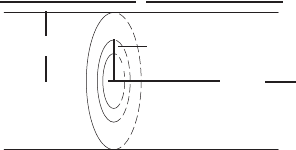
SOLUTIONS to Review Problems for Chapter Eight 841
Then,
Number of photons detected on ring per unit time ≈Number hitting ·S(r)≈N·2πr∆r·S(r).
Summing over all rings gives us
Total number of photons detected per unit time ≈X2πNrS(r)∆r.
Taking the limit as ∆r→0gives
Total number of photons detected per unit time =ZR
0
2πNrS(r)dr.
83. The number of houses in a ring of width ∆ra distance rifrom the city center is given by:
Number houses =1000 houses/mi2×Area of ring
= 1000 ·2πri∆r= 2000πri∆r.
The value of the houses in this ring is given by:
Value =Price per house ×Number of houses
=p(ri)·1000 ·2πri∆r= 2000πrip(ri) ∆r.
The total value of the houses within 7 miles of the city center is therefore
Total value = lim
n→∞
n
X
i=1
2000πrip(ri) ∆r
=Z7
0
2000πrp (r)dr
= 2000πZ7
0
400e−0.2r2rdr
= 800,000πZr=7
r=0
ew2(−2.5) dw let w=−0.2r2, dw =−0.4rdr
=−2,000,000πZr=7
r=0
ewdw
=−2,000,000πe−0.2r2
7
0
=−2,000,000πe−0.2(7)2−e−0.2(0)2= 6,282,837.
This figure is in $1000s, so the total value of homes is approximately $6.2828 billion.
84. (a) Divide the cross-section of the blood into rings of radius r, width ∆r. See Figure 8.178.
✻
❄
R✻
❄
✻
❄
✲✛ l
r
✛∆r
v=P R2
4ηl
✲
Figure 8.178
Then
Area of ring ≈2πr∆r.
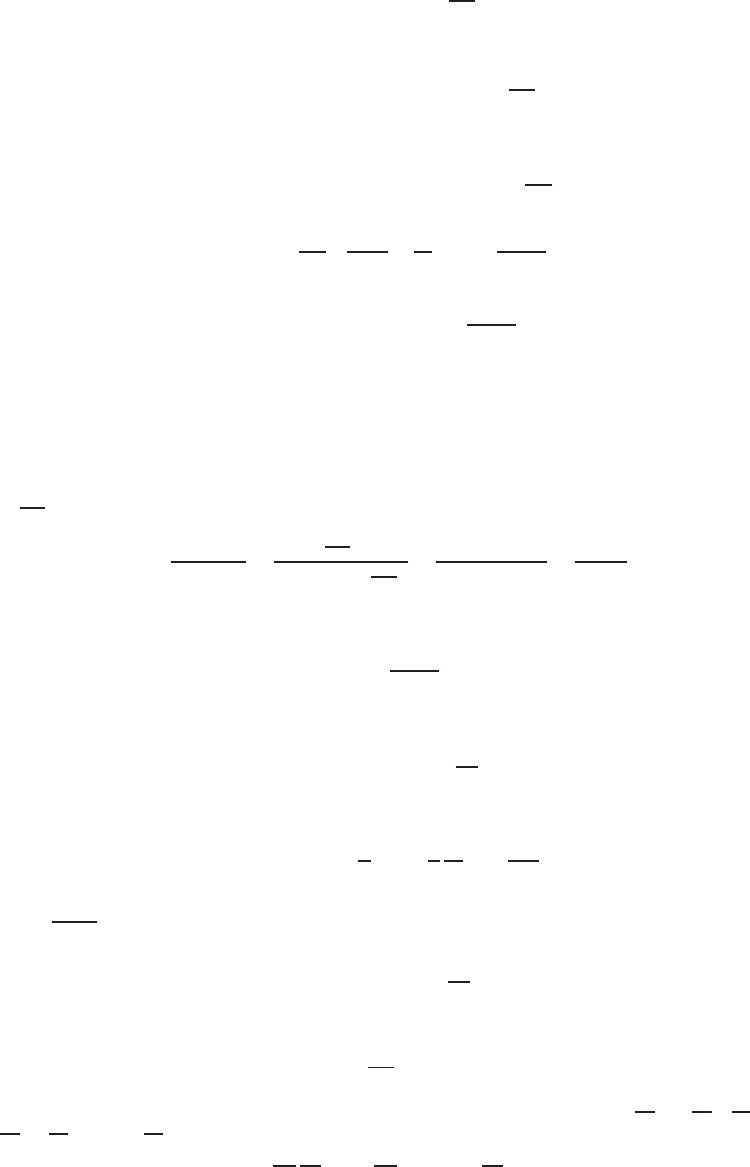
842 Chapter Eight /SOLUTIONS
The velocity of the blood is approximately constant throughout the ring, so
Rate blood flows through ring ≈Velocity ·Area
=P
4ηl (R2−r2)·2πr∆r.
Thus, summing over all rings, we find the total blood flow:
Rate blood flowing through blood vessel ≈XP
4ηl (R2−r2)2πr∆r.
Taking the limit as ∆r→0, we get
Rate blood flowing through blood vessel =ZR
0
πP
2ηl (R2r−r3)dr
=πP
2ηl R2r2
2−r4
4
R
0
=πP R4
8ηl .
(b) Since
Rate of blood flow =πP R4
8ηl ,
if we take k=πP/(8ηl), then we have
Rate of blood flow =kR4,
that is, rate of blood flow is proportional to R4, in accordance with Poiseuille’s Law.
85. Pick a small interval of time ∆twhich takes place at time t. Fuel is consumed at a rate of (25 + 0.1v)−1gallons per
mile. In the time ∆t, the car moves v∆tmiles, so it consumes v∆t/(25 + 0.1v)gallons during the instant ∆t. Since
v= 50 t
t+1 , the car consumes
v∆t
25 + 0.1v=50 t
t+1 ∆t
25 + 0.150 t
t+1 =50t∆t
25(t+ 1) + 5t=10t∆t
6t+ 5
gallons of gas, in terms of the time tat which the instant occurs. To find the total gas consumed, sum up the instants in an
integral:
Gas consumed =Z3
2
10t
6t+ 5 dt ≈1.25 gallons.
86. (a) Slicing horizontally, as shown in Figure 8.179, we see that the volume of one disk-shaped slab is
∆V≈πx2∆y=πy
a∆y.
Thus, the volume of the water is given by
V=Zh
0
π
aydy =π
a
y2
2
h
0
=πh2
2a.
(b) The surface of the water is a circle of radius x. Since at the surface, y=h, we have h=ax2. Thus, at the surface,
x=p(h/a). Therefore the area of the surface of water is given by
A=πx2=πh
a.
(c) If the rate at which water is evaporating is proportional to the surface area, we have
dV
dt =−kA.
(The negative sign is included because the volume is decreasing.) By the chain rule, dV
dt =dV
dh ·dh
dt . We know
dV
dh =πh
aand A=πh
aso
πh
a
dh
dt =−kπh
agiving dh
dt =−k.
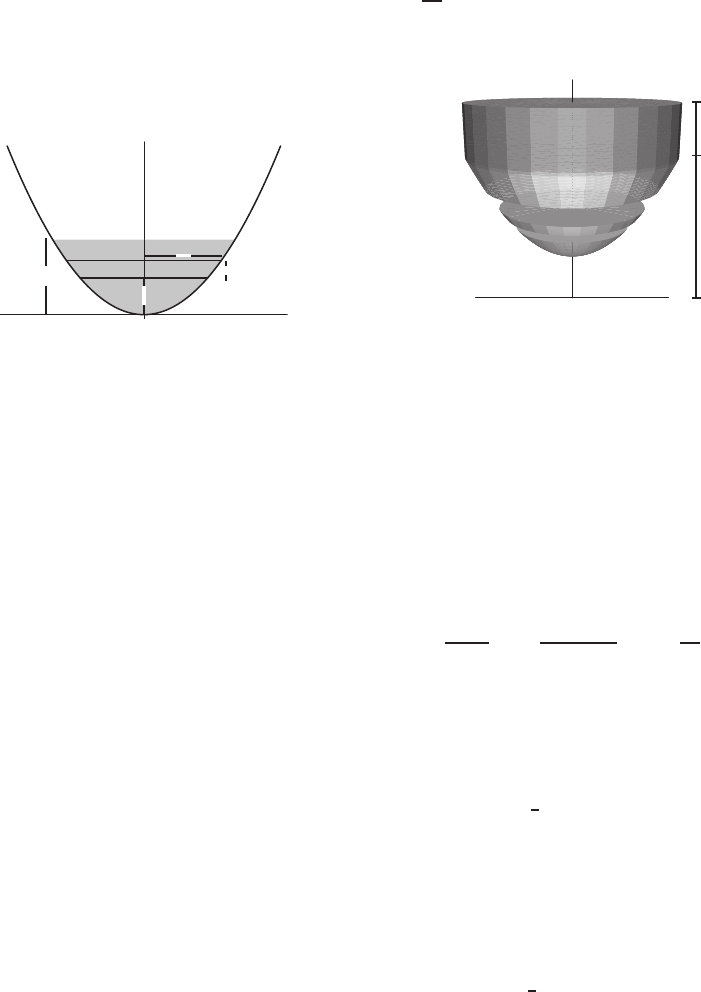
SOLUTIONS to Review Problems for Chapter Eight 843
(d) Integrating gives
h=−kt +h0.
Solving for twhen h= 0 gives
t=h0
k.
x
y
✲✛ x
✻
❄
y
✻
❄
h✻
❄
∆y
y=ax2
Figure 8.179
x
y
1
✻
❄
h+b
✻
❄
2−(h+b)
Figure 8.180
87. (a) The volume of water in the centrifuge is π(12)·1 = πcubic meters. The centrifuge has total volume 2πcubic meters,
so the volume of the air in the centrifuge is πcubic meters. Now suppose the equation of the parabola is y=h+bx2.
We know that the volume of air in the centrifuge is the volume of the top part (a cylinder) plus the volume of the
middle part (shaped like a bowl). See Figure 8.180.
To find the volume of the cylinder of air, we find the maximum water depth. If x= 1, then y=h+b. Therefore
the height of the water at the edge of the bowl, 1 meter away from the center, is h+b. The volume of the cylinder of
air is therefore [2 −(h+b)] ·π·(1)2= [2 −h−b]π.
To find the volume of the bowl of air, we note that the bowl is a volume of rotation with radius xat height y,
where y=h+bx2. Solving for x2gives x2= (y−h)/b. Hence, slicing horizontally as shown in the picture:
Bowl Volume =Zh+b
h
πx2dy =Zh+b
h
πy−h
bdy =π(y−h)2
2b
h+b
h
=bπ
2.
So the volume of both pieces together is [2 −h−b]π+bπ/2 = (2 −h−b/2)π. But we know the volume of air
should be π, so (2 −h−b/2)π=π, hence h+b/2 = 1 and b= 2 −2h. Therefore, the equation of the parabolic
cross-section is y=h+ (2 −2h)x2.
(b) The water spills out the top when h+b=h+ (2 −2h) = 2, or when h= 0. The bottom is exposed when h= 0.
Therefore, the two events happen simultaneously.
88. Any small piece of mass ∆Mon either of the two spheres has kinetic energy 1
2v2∆M. Since the angular velocity of the
two spheres is the same, the actual velocity of the piece ∆Mwill depend on how far away it is from the axis of revolution.
The further away a piece is from the axis, the faster it must be moving and the larger its velocity v. This is because if ∆M
is at a distance rfrom the axis, in one revolution it must trace out a circular path of length 2πr about the axis. Since every
piece in either sphere takes 1 minute to make 1 revolution, pieces farther from the axis must move faster, as they travel a
greater distance.
Thus, since the thin spherical shell has more of its mass concentrated farther from the axis of rotation than does the
solid sphere, the bulk of it is traveling faster than the bulk of the solid sphere. So, it has the higher kinetic energy.
89. Any small piece of mass ∆Mon either of the two hoops has kinetic energy 1
2v2∆M. Since the angular velocity of the
two hoops is the same, the actual velocity of the piece ∆Mwill depend on how far away it is from the axis of revolution.
The further away a piece is from the axis, the faster it must be moving and the larger its velocity v. This is because if ∆M
is at a distance rfrom the axis, in one revolution it must trace out a circular path of length 2πr about the axis. Since every
piece in either hoop takes 1 minute to make 1 revolution, pieces farther from the axis must move faster, as they travel a
greater distance.
The hoop rotating about the cylindrical axis has all of its mass at a distance Rfrom the axis, whereas the other hoop
has a good bit of its mass close (or on) the axis of rotation. So, since the bulk of the hoop rotating about the cylindrical
axis is traveling faster than the bulk of the other hoop, it must have the higher kinetic energy.
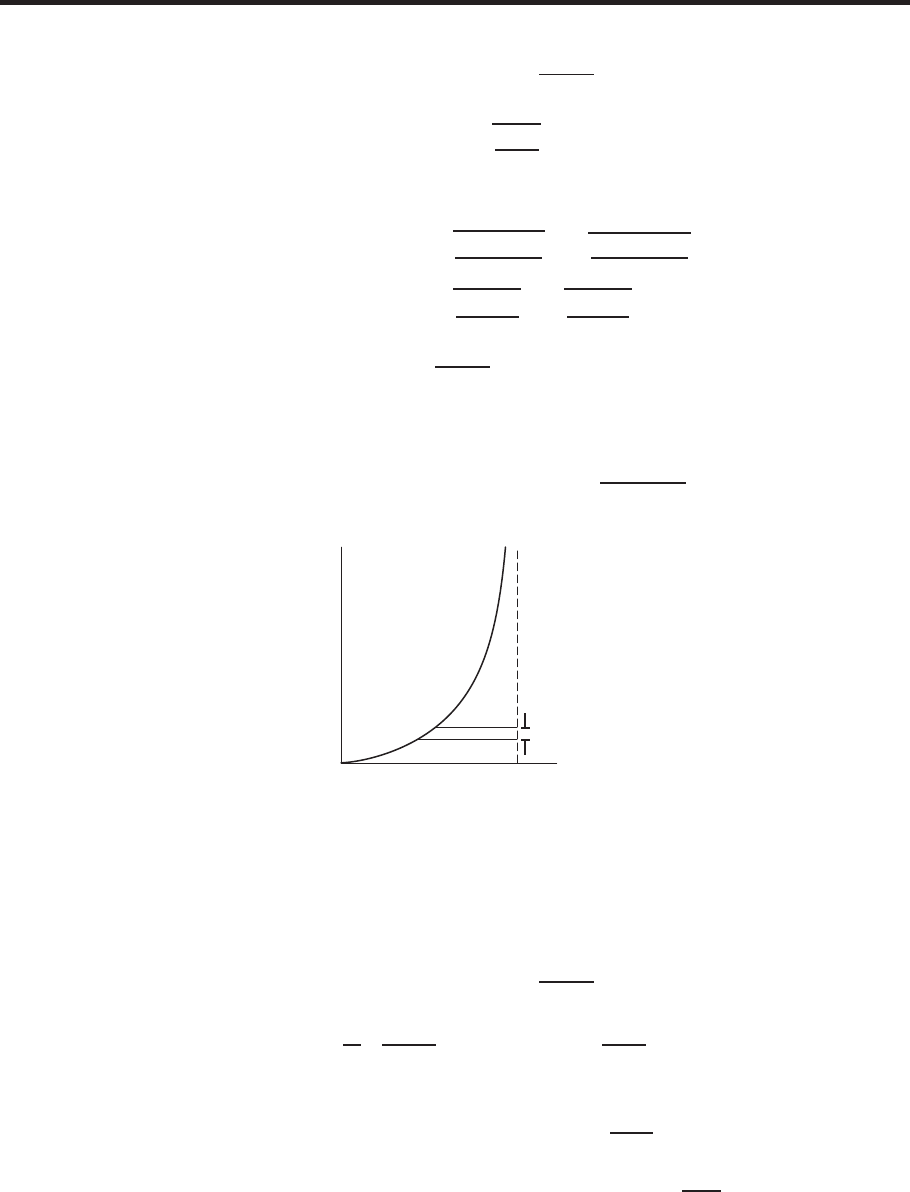
844 Chapter Eight /SOLUTIONS
CAS Challenge Problems
90. (a) We need to check that the point with the given coordinates is on the curve, i.e., that
x=asin2t, y =asin3t
cos t
satisfies the equation
y=rx3
a−x.
This can be done by substituting into the computer algebra system and asking it to simplify the difference between
the two sides, or by hand calculation:
Right-hand side =r(asin2t)3
a−asin2t=ra3sin6t
a(1 −sin2t)
=ra3sin6t
acos2t=ra2sin6t
cos2t
=asin3t
cos t=y=Left-hand side.
We chose the positive square root because both sin tand cos tare nonnegative for 0≤t≤π/2. Thus the point always
lies on the curve. In addition, when t= 0,x= 0 and y= 0, so the point starts at x= 0. As tapproaches π/2, the
value of x=asin2tapproaches aand the value of y=asin3t/ cos tincreases without bound (or approaches ∞),
so the point on the curve approaches the vertical asymptote at x=a.
(b) We calculate the volume using horizontal slices. See the graph of y=px3/(a−x)in Figure 8.181.
a
✻
❄
x−a
∆y
x
y
Figure 8.181
The slice at yis a disk of thickness ∆yand radius x−a, hence it has volume π(x−a)2∆y. So the volume is
given by the improper integral
Volume =Z∞
0
π(x−a)2dy.
(c) We substitute
x=asin2t, y =asin3t
cos t
and
dy =d
dt asin3t
cos tdt =a3 sin2t+sin4t
cos2tdt.
Since t= 0 where y= 0 and t=π/2at the asymptote where y→ ∞, we get
Volume =Zπ/2
0
π(asin2t−a)2a3 sin2t+sin4t
cos2tdt
=πa3Zπ/2
0
(3 sin2tcos4t+ sin4tcos2t)dt =π2a3
8.
You can use a CAS to calculate this integral; it can also be done using trigonometric identities.
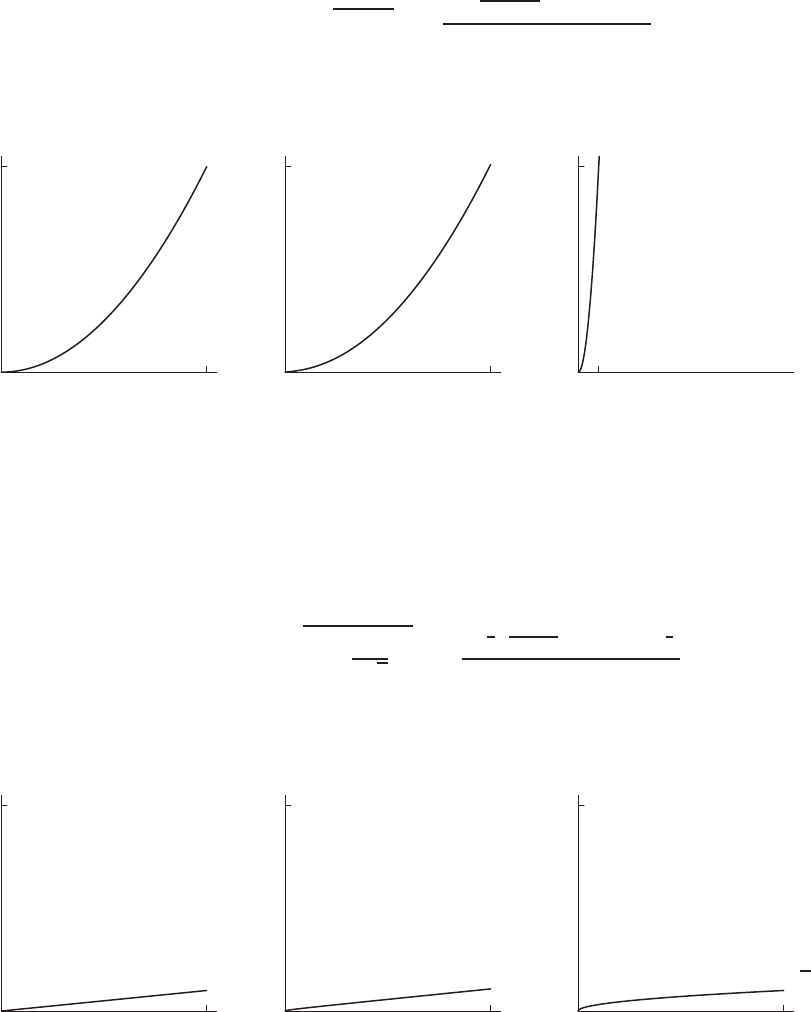
SOLUTIONS to Review Problems for Chapter Eight 845
91. (a) The expression for arc length in terms of a definite integral gives
A(t) = Zt
0p1 + 4x2dx =2t√1 + 4 t2+arcsinh (2 t)
4.
The integral was evaluated using a computer algebra system; different systems may give the answer in different
forms. Here arcsinh is the inverse function of the hyperbolic sine function.
(b) Figure 8.182 shows that the graphs of A(t)and t2look very similar. This suggests that A(t)≈t2.
10
100 t2
t
y
10
100 A(t)
t
y
Figure 8.182
10
100
x
y
y=x2
Figure 8.183
(c) The graph in Figure 8.183 is approximately vertical and close to the yaxis. Thus, if we measure the arc length up to a
certain y-value, the answer is approximately the same as if we had measured the length straight up the y-axis. Hence
A(t)≈y=f(t) = t2.
So
A(t)≈t2.
92. (a) The expression for arc length in terms of a definite integral gives
A(t) = Zt
0s1 + 1
2√x2
dx =2√t√1 + 4t+arcsinh (2√t)
4.
The integral was evaluated using a computer algebra system; different systems may give the answer in different
forms. Some may involve ln instead of arcsinh, which is the inverse function of the hyperbolic sine function.
(b) Figure 8.185 shows that the graphs of A(t)and the graph of y=tlook very similar. This suggests that A(t)≈t.
10
100
y=t
t
y
10
100
A(t)
t
y
Figure 8.184
100
100
x
y
y=√x
Figure 8.185
(c) The graph in Figure 8.185 is approximately horizontal and close to the x-axis. Thus, if we measure the arc length up
to a certain x-value, the answer is approximately the same as if we had measured the length straight along the x-axis.
Hence
A(t)≈x=t.
So
A(t)≈t.
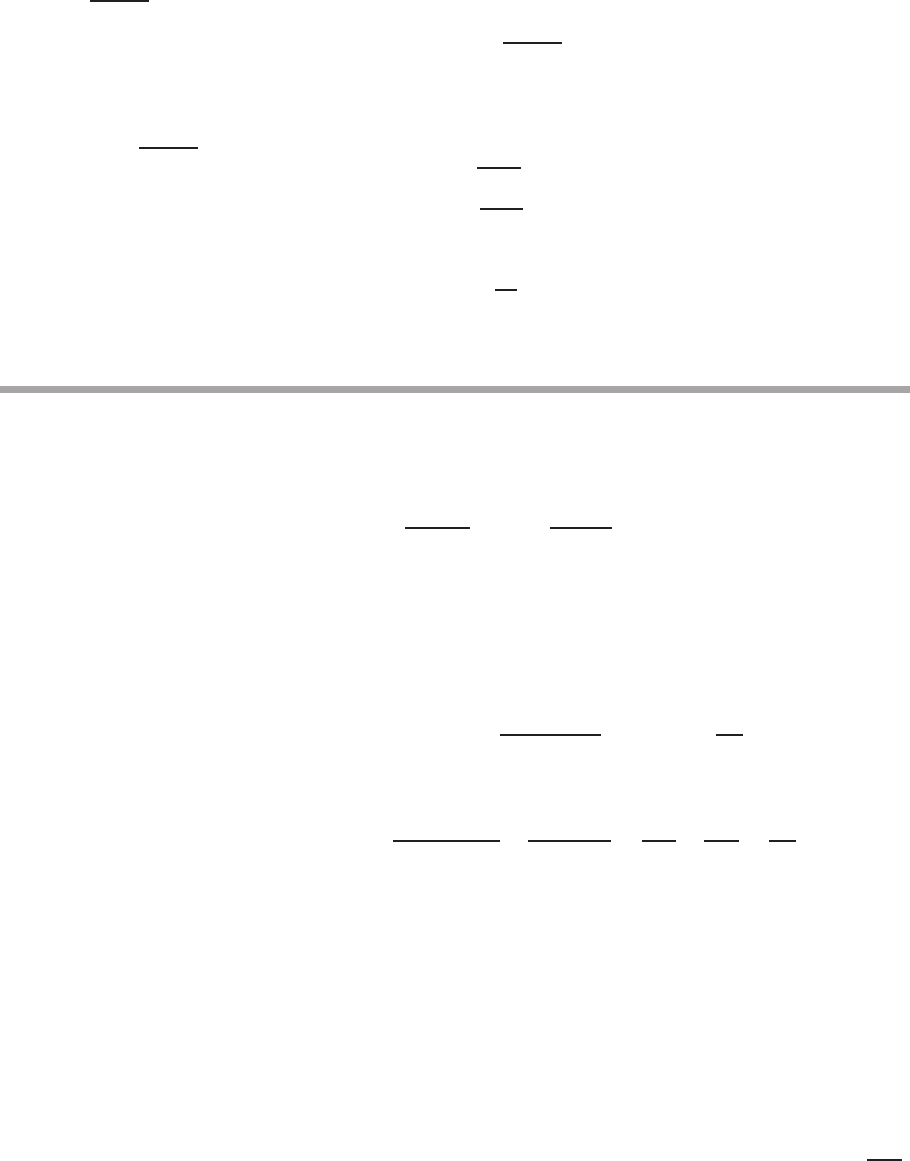
846 Chapter Eight /SOLUTIONS
93. (a) Slice the sphere at right angles to the axis of the cylinder. Consider a slice of thickness ∆xat distance xfrom
the center of the sphere. The cross-section is an annulus (ring) with internal radius ri=aand outer radius ro=
√r2−x2. Thus
Area of annulus =πro2−πri2=πpr2−x22
−πa2=π(r2−x2−a2).
Volume of slice ≈π(r2−x2−a2)∆x.
The lower and upper limits of the integral are where the cylinder meets the sphere, i.e., where x2+a2=r2, or
x=±√r2−a2. Thus
Volume of bead =Z√r2−a2
−√r2−a2
π(r2−x2−a2)dx.
(b) Using a computer algebra system to evaluate the integral, we have
Volume of bead =4π
3r2−a23/2.
PROJECTS FOR CHAPTER EIGHT
1. (a) The hydrostatic pressure phis a linear function of distance x, so ph=b+mx. At the artery end, x= 0,
and ph= 35.At the vein end, x=L= 0.1and ph= 15. This means the points (0,35) and (0.1,15) are
on the graph of ph, so the slope is given by
m=15 −35
0.1−0=−200 mm Hg
cm .
We know that b= 35, so ph= 35 −200xmm Hg.
(b) The net pressure, p, is the difference between the hydrostatic pressure and the oncotic pressure. Using
part (a), we have
p=ph−po= (35 −200x)−23 = 12 −200xmm Hg.
(c) Since j=k·p, we have
junits = (kunits)×(punits) = cm
sec ·mm Hg ×mm Hg =cm
sec .
In addition
Volume/time/area units =Volume units
Time units ×1
Area units =cm3
sec ×1
cm2=cm
sec .
Thus, jhas units of volume per time per area.
(d) To find the flow rate through a small section of length ∆xof the capillary, we multiply j, the flow rate per
capillary wall area, by the area, A= 2πr ∆xof the section. To find the flow through the wall of the entire
capillary, we integrate. Thus,
Flow rate =ZL
0
j·2πr dx =ZL
0
kp ·2πr dx
Using the formula for pfrom part (b), and the values L= 0.1cm, r= 0.0004 cm, and k= 10−7cm/(sec·
mm Hg), evaluating the integral symbolically or numerically, we have
Flow rate =Z0.1
0
2π(10−7)(0.0004)(12−200x)dx = 8·10−11π(12x−100x2)
0.1
0
= 5.03 ·10−11 cm3
sec .

PROJECTS FOR CHAPTER EIGHT 847
2. (a) The volume of a cylinder of radius rand height his V=πr2h. Since the total volume of the urine sample
is 2000 ml and the diameter is 10 cm (so the radius is 5 cm), we have:
πr2h=π52h=2000
h=2000
25π= 25.46 cm.
Thus, the depth of urine in the cylinder is 25.46 cm.
(i) The protein concentration cis a linear function of height y, so c=b+my. At the bottom of the
sample, y= 0, and c= 0.96. At the top, y= 25.46 and c= 0.14. This means the points (0,0.96)
and (25.46,0.14) are on the graph of c, so the slope is given by
m=0.14 −0.96
25.46 −0=−0.0322 mg
ml ·cm .
We know that b= 0.96, so c= 0.96 −0.0322ymg/ml.
(ii) A cross sectional slice of the cylinder has volume 52π∆y=25π∆y. This means the quantity of
protein in a given slice is
∆Q=Volume
| {z }
25π∆y×Concentration
| {z }
0.96−0.0322y
= 25π∆y(0.96 −0.0322y)mg.
(iii) To find the total quantity of protein, we integrate:
Total mass =Z25.46
y=0
25π(0.96 −0.0322y)dy
= 25π0.96y−0.0161y2
25.46
0
= 1099.98mg.
Thus, the patient excreted approximately 1100 mg, or 1.1 gm, of protein during the 24 hour period
in which urine was collected. This is above the threshold of 1 gm per 24 hour period at which active
treatment is recommended.
(b) Let the radius of the collection container be r, the volume of the urine be V, and the concentrations of
protein at the top and bottom of the collected fluid be ctand cb. We compute the quantity of protein by
following the procedure of part (a).
If his the depth of the sample, we have
V=πr2h.
Assuming that protein concentration, c, is a linear function of the distance, y, from the bottom of the
container, we have
c=cb+my
where the slope mis given by
m=ct−cb
h.
The quantity of protein in a horizontal slice is
∆Q=Volume ×Concentration =πr2∆y·c.
To find the total quantity of protein in the container, we integrate:
Total mass =Zh
0
πr2c(y)dy=Zh
0
πr2(cb+my)dy

848 Chapter Eight /SOLUTIONS
=πr2cby+my2
2
h
0
=πr2cbh+mh2
2
=πr2cbh+ct−cb
h·h2
2=πr2hcb+ct−cb
2
=ct+cb
2V.
Thus, the quantity of protein in the sample is the product of the average of the top and bottom protein
concentrations by the volume of urine collected.
3. Let us make coordinate axes with the origin at the center of the box. The xand yaxes will lie along the central
axes of the cylinders, and the (height) axis will extend vertically to the top of the box. If one slices the cylinders
horizontally, one gets a cross. The cross is what you get if you cut out four corner squares from a square of side
length 2. If his the height of the cross above (or below) the xy plane, the equation of a cylinder is h2+y2= 1
(or h2+x2= 1). Thus the “armpits” of the cross occur where y2−1 = −h2=x2−1for some fixed height
h—that is, out √1−h2units from the center, or 1−√1−h2units away from the edge. Each corner square
has area (1 −√1−h2)2= 2 −h2−2√1−h2.The whole big square has area 4. Therefore, the area of the
cross is
4−4(2 −h2−2p1−h2) = −4 + 4h2+ 8p1−h2.
✛ ✲✛ ✲
✻
❄
✛✲
√1−h2
1−√1−h2
1−√1−h2
2
We integrate this from h=−1to h= 1, and obtain the volume, V:
V=Z1
−1−4+ 4h2+ 8p1−h2dh
="−4h+4h3
3+ 8 ·1
2hp1−h2+ arcsin h#
1
−1
=−8 + 8
3+ 4π= 4π−16
3≈7.23.
This is a reasonable answer, as the volume of the cube is 8, and the volume of one cylinder alone is 2π≈6.28.
4. (a) Let yrepresent height, and let xrepresent horizontal distance from the lowest point of the cable. Then the
stretched cable is a parabola of the form y=kx2passing through the point (1280/2,143) = (640,143).
Therefore, 143 = k(640)2so k≈3.491 ×10−4. To find the arc length of the parabola, we take twice the
arc length of the part to the right of the lowest point. Since dy/dx = 2kx,
Arc Length = 2 Z640
0p1 + (2kx)2dx = 2 Z640
0p1+4k2x2dx.
The easiest way to find this integral is to substitute the value of kand find the integral’s value numer-
ically, giving
Arc Length ≈1321.4meters.
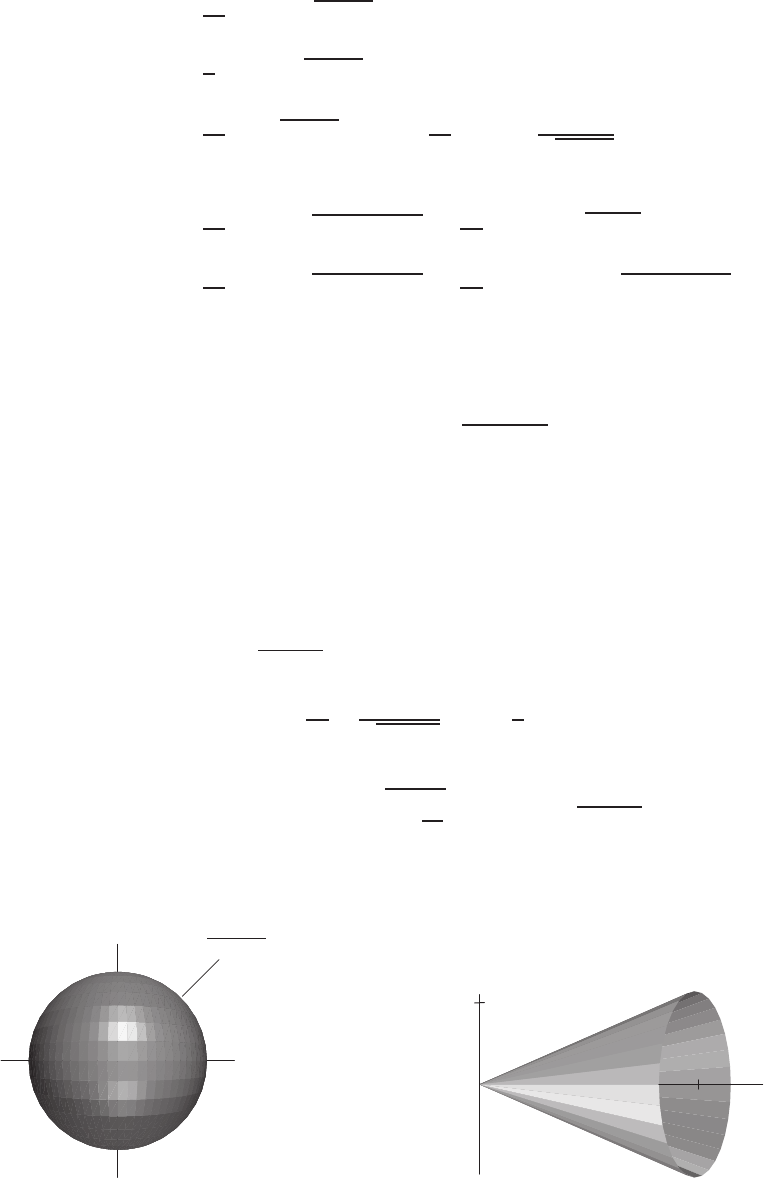
PROJECTS FOR CHAPTER EIGHT 849
Alternatively, we can make the substitution w= 2kx:
Arc Length =2
2kZ1280k
0p1 + w2dw
=1
kZ1280k
0p1 + w2dw
=1
2k wp1 + w2
1280k
0!+1
2k Z1280k
0
1
√1 + w2dw!
[Using the integral table, Formula VI-29, or substitute w= tan θ]
=1
2k1280kp1 + (1280k)2+1
2k ln x+p1 + x2
1280k
0!
=1
2k1280kp1 + (1280k)2+1
2kln 1280k+p1 + (1280k)2
≈1321.4meters.
(b) Adding 0.05% to the length of the cable gives a cable length of (1321.4)(1.0005) = 1322.1. We now want
to calculate the new shape of the parabola; that is, we want to find a new kso that the arc length is 1322.1.
Since
Arc Length = 2 Z640
0p1+4k2x2dx
we can find knumerically by trial and error. Trying values close to our original value of k, we find
k≈3.52 ×10−4. To find the sag for this new k, we find the height y=kx2for which the cable hangs
from the towers. This is
y=k(640)2≈144.2.
Thus the cable sag is 144.2meters, over a meter more than on a cold winter day. Notice, though, that
although the length increases by 0.05%, the sag increases by more:144.2/143 ≈1.0084, an increase of
0.84%.
5. (a) Revolving the semi-circle y=√r2−x2around the x-axis yields the sphere of radius r. See Figure 8.186.
Differentiating yields:
dy
dx =−1
√r2−x2·x=−x
y.
Thus, substituting −x/y for f′(x), we get
Surface area = 2πZr
−r
ys1 + x2
y2dx =2πZr
−rpx2+y2dx
= 2πr Zr
−r
dx =4πr2.
x
y
r
−r
✠
y=√r2−x2
Figure 8.186
x
y
r
h
Figure 8.187
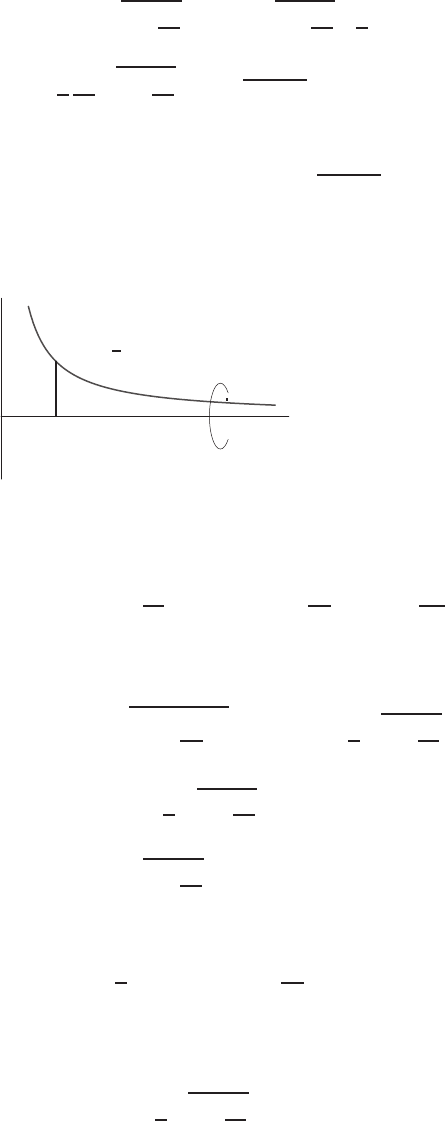
850 Chapter Eight /SOLUTIONS
(b) Revolving the line y=rx/h around the x-axis yields the cone. The base of the cone is a circle with area
πr2. See Figure 8.187. The area of the rest of the cone is
Surface area = 2πZh
0
yr1 + r2
h2dx = 2πr1 + r2
h2 r
hZh
0
x dx!
= 2πr
h
h2
2r1 + r2
h2=πrpr2+h2
Adding the area of the base, we get
Total surface area of cone =πr2+πrpr2+h2.
(c) We find the volume of y= 1/x revolved about the x-axis as xruns from 1 to ∞. See Figure 8.188.
1
y=1
x
❄
x
y
Figure 8.188
Volume =Z∞
1
πy2dx =πZ∞
1
1
x2dx =πlim
b→∞ Zb
1
dx
x2=πlim
b→∞ −1
x
b
1
=π
Thus, the volume of this solid is finite and equal to π.
(d) Now we show the surface area of this solid is unbounded. We have
Surface area = 2πZ∞
1
ys1 + dy
dx2
dx = 2πZ∞
1
1
xr1 + 1
x4dx
We cannot easily compute the antiderivative of 1
xr1 + 1
x4, so we bound the integral from below by
noticing that r1 + 1
x4≥1.
Thus we see that
Surface area ≥2πZ∞
1
1
xdx = 2πlim
b→∞ Zb
1
dx
x= 2πlim
b→∞
ln x
b
1
.
Since ln xgoes to infinity as xgoes to infinity, the surface area is unbounded.
Alternatively, we can try calculating
2πZb
1
1
xr1 + 1
x4dx
for larger and larger values of b. We would see that the integral seems to diverge.
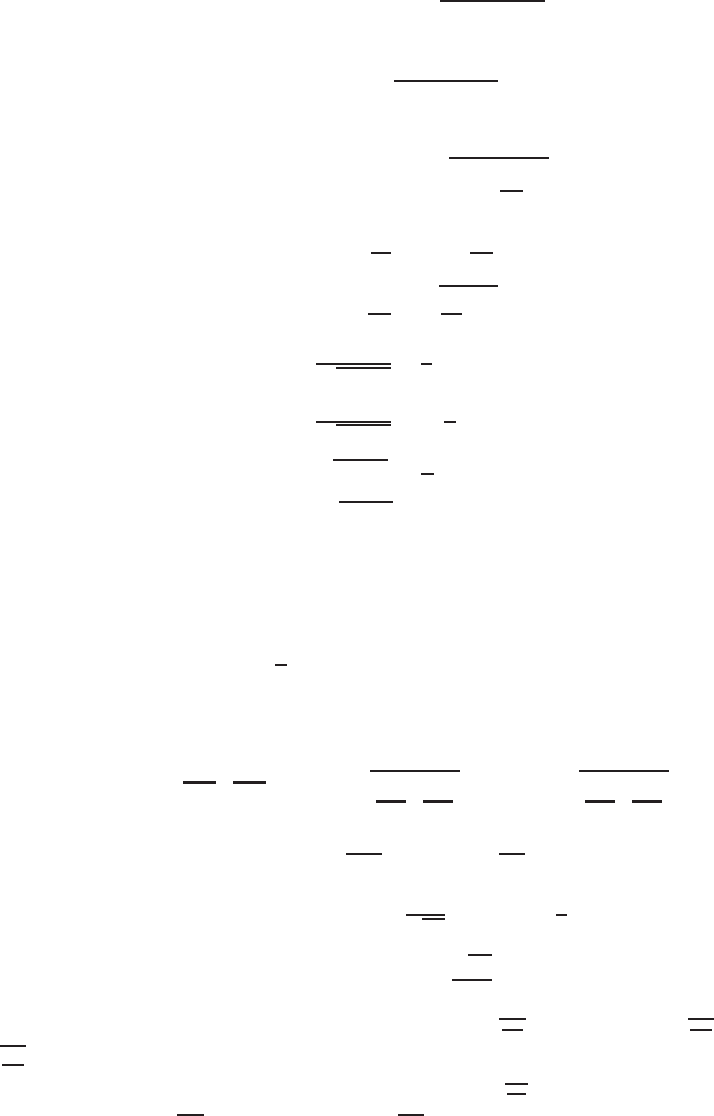
PROJECTS FOR CHAPTER EIGHT 851
(e) For a solid generated by the revolution of a curve y=f(x)for a≤x≤b,
Volume =Zb
a
πy2dx
and
Surface area =Zb
a
2πyp1+(f′(x))2dx.
The volume and the surface area will be equal if
f(x) = 2p1+(f′(x))2.
We find a function y=f(x)which satisfies this relation:
y= 2s1 + dy
dx 2
y2
4= 1 + dy
dx2
dy
dx =ry2
4−1
dy
py2−4=1
2dx
Zdy
py2−4=Z1
2dx
ln |y+py2−4|=x
2+C
y+py2−4 = Aex/2
Notice in the third line we have used the fact that dy/dx ≥0. Any function, y=f(x), which satisfies this
relationship has the required property.
6. (a) We want to find asuch that R∞
0p(v)dv = lim
r→∞aRr
0v2e−mv2/2kT dv = 1. Therefore,
1
a= lim
r→∞ Zr
0
v2e−mv2/2kT dv.
To evaluate the integral, use integration by parts with the substitutions u=vand w′=ve−mv2/2kT :
Zr
0
v
|{z}
u
ve−mv2/2kT
| {z }
w′
dv =v
|{z}
u
e−mv2/2kT
−m/kT
|{z }
w
r
0−Zr
0
1
|{z}
u′
e−mv2/2kT
−m/kT
|{z }
w
dv
=−kT r
me−mr2/2kT +kT
mZr
0
e−mv2/2kT dv.
From the normal distribution we know that Z∞
0
1
√2πe−x2/2dx =1
2, so
Z∞
0
e−x2/2dx =√2π
2.
Therefore in the above integral, make the substitution x=pm
kT v, so that dx =pm
kT dv, or dv =
qkT
mdx. Then
kT
mZr
0
e−mv2/2kT dv =kT
m3/2Z√m
kT r
0
e−x2/2dx.

852 Chapter Eight /SOLUTIONS
Substituting this into Equation 6a we get
1
a= lim
r→∞ −kT r
me−mr2/2kT +kT
m3/2Z√m
kT r
0
e−x2/2dx=0 + kT
m3/2
·√2π
2.
Therefore, a=2
√2π(m
kT )3/2. Substituting the values for k,T, and mgives a≈3.4×10−8.
(b) To find the median, we wish to find the speed xsuch that
Zx
0
p(v)dv=Zx
0
av2e−mv2
2kT dv =1
2,
where a=2
√2π(m
kT )3/2.Using a calculator, by trial and error we get x≈441 m/sec.
To find the mean, we find Z∞
0
vp(v)dv =Z∞
0
av3e−mv2
2kT dv.
This integral can be done by substitution. Let u=v2,sodu = 2vdv. Then
Z∞
0
av3e−mv2
2kT dv =a
2Zv=∞
v=0
v2e−mv2
2kT 2v dv
=a
2Zu=∞
u=0
ue−mu
2kT du
= lim
r→∞
a
2Zr
0
ue−mu
2kT du.
Now, using the integral table, we have
Z∞
0
av3e−mv2
2kT dv = lim
r→∞
a
2"−2kT
mue−mu
2kT −−2kT
m2
e−mu
2kT #
r
0
=a
2−2kT
m2
≈457.7m/sec.
The maximum for p(v)will be at a point where p′(v) = 0.
p′(v) = a(2v)e−mv2
2kT +av2−2mv
2kT e−mv2
2kT
=ae−mv2
2kT 2v−v3m
kT .
Thus p′(v) = 0 at v= 0 and at v=r2kT
m≈405.It’s obvious that p(0) = 0, and that p→0as v→ ∞.
So v= 405 gives us a maximum: p(405) ≈0.002.
(c) The mean, as we found in part (b), is a
2
4k2T2
m2=4
√2π
k1/2T1/2
m1/2.It is clear, then, that as Tincreases so
does the mean. We found in part (b) that p(v)reached its maximum at v=r2kT
m.Thus
The maximum value of p(v) = 2
√2πm
kT 3/22kT
me−1
=4
e√2π
m1/2
kT 1/2.
Thus as Tincreases, the maximum value decreases.

9.1 SOLUTIONS 853
CHAPTER NINE
Solutions for Section 9.1
Exercises
1. The first term is 21+ 1 = 3. The second term is 22+ 1 = 5. The third term is 23+ 1 = 9, the fourth is 24+ 1 = 17, and
the fifth is 25+ 1 = 33. The first five terms are 3,5,9,17,33.
2. The first term is 1 + (−1)1= 1 −1 = 0. The second term is 2 + (−1)2= 2 + 1 = 3. The third term is 3−1 = 2 and
the fourth is 4 + 1 = 5. The first five terms are 0,3,2,5,4.
3. The first term is 2·1/(2 ·1 + 1) = 2/3. The second term is 2·2/(2 ·2 + 1) = 4/5. The first five terms are
2/3,4/5,6/7,8/9,10/11.
4. The first term is (−1)1(1/2)1=−1/2. The second term is (−1)2(1/2)2= 1/4. The first five terms are
−1/2,1/4,−1/8,1/16,−1/32.
5. The first term is (−1)2(1/2)0= 1. The second term is (−1)3(1/2)1=−1/2. The first five terms are
1,−1/2,1/4,−1/8,1/16.
6. The first term is (1 −1/(1 + 1))(1+1) = (1/2)2. The second term is (1 −1/3)3= (2/3)3. The first five terms are
(1/2)2,(2/3)3,(3/4)4,(4/5)5,(5/6)6.
7. The terms look like powers of 2so we guess sn= 2n. This makes the first term 21= 2 rather than 4. We try instead
sn= 2n+1. If we now check, we get the terms 4,8,16,32,64, . . ., which is right.
8. We compare with positive powers of 2, which are 2,4,8,16,32, . . .. Each term is one less, so we take sn= 2n−1.
9. We observe that if we subtract 1from each term of the sequence, we get 1,4,9,16,25, . . ., namely the squares 12,22,32,42,52,....
Thus sn=n2+ 1.
10. First notice that sn= 2n−1is a formula for the general term of the sequence
1,3,5,7,9,....
To obtain the alternating signs in the original sequence, we try multiplying by (−1)n. However, checking (−1)n(2n−1)
for n= 1,2,3, . . . gives
−1,3,−5,7,−9,....
To get the correct signs, we multiply by (−1)n+1 and take
sn= (−1)n+1(2n−1).
11. The numerator is n. The denominator is then 2n+ 1, so sn=n/(2n+ 1).
12. The denominators are the even numbers, so we try sn= 1/(2n). To get the signs to alternate, we try multiplying by
(−1)n. That gives
−1/2,1/4,−1/6,1/8,−1/10, . . . ,
so we multiply by (−1)n+1 instead. Thus sn= (−1)n+1/(2n).
Problems
13. Since 2nincreases without bound as nincreases, the sequence diverges.
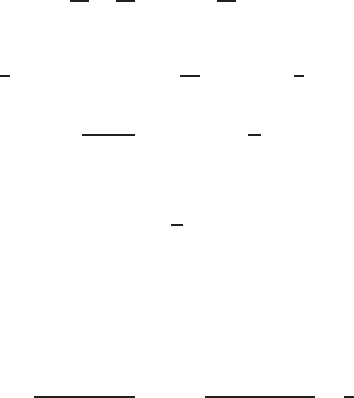
854 Chapter Nine /SOLUTIONS
14. Since lim
n→∞ xn= 0 if |x|<1and |0.2|<1, we have lim
n→∞(0.2)n= 0, so the sequence converges to 0
15. Since lim
n→∞ xn= 0 if |x|<1and |e−2|<1, we have lim
n→∞(e−2n) = lim
n→∞(e−2)n= 0, so lim
n→∞(3+e−2n) = 3+0 = 3,
so the sequence converges to 3.
16. Since lim
n→∞ xn= 0 if |x|<1and | − 0.3|<1, we have lim
n→∞(−0.3)n= 0, so the sequence converges to 0.
17. We have:
lim
n→∞ n
10 +10
n= lim
n→∞
n
10 + lim
n→∞ 10n.
Since n/10 gets arbitrarily large and 10/n approaches 0as n→ ∞, the sequence diverges.
18. Since lim
n→∞ xn= 0 if |x|<1and
2
3<1, we have lim
n→∞ 2n
3n= lim
n→∞ 2
3n
= 0, so the sequence converges to 0.
19. We have
lim
n→∞
2n+ 1
n= lim
n→∞ 2 + 1
n= 2,
so the sequence converges to 2.
20. We have:
lim
n→∞ 1
n= 0.
The terms of the sequence alternate in sign, but they approach 0, so the sequence converges to 0.
21. Since 1/n approaches zero and ln nbecomes arbitrarily large as n→ ∞, the sequence diverges.
22. As nincreases, the term 2nis much larger in magnitude than (−1)n5and the term 4nis much larger in magnitude than
(−1)n3. Thus dividing the numerator and denominator by nand using the fact that lim
n→∞ 1/n = 0, we have
lim
n→∞
2n+ (−1)n5
4n−(−1)n3= lim
n→∞
2 + (−1)n5/n
4−(−1)n3/n =1
2.
Thus, the sequence converges to 1/2.
23. Since limn→∞ 1/n = 0 and −1≤sin n≤1, the terms approach zero and the sequence converges to 0.
24. Since sn= cos(πn) = 1 if nis even and sn= cos(πn) = −1if nis odd, the values of snalternate between 1 and −1,
so the limit does not exist. Thus, the sequence diverges.
25. (a) matches (IV), since the sequence increases toward 1.
(b) matches (III), since the odd terms increase toward 1and the even terms decrease toward 1.
(c) matches (II), since the sequence decreases toward 0.
(d) matches (I), since the sequence decreases toward 1.
26. (a) matches (II), since limn→∞(n(n+ 1) −1) = ∞.
(b) matches (III), since limn→∞(1/(n+ 1)) = 0 and 1/(n+ 1) is always positive.
(c) matches (I), since limn→∞(1 −n2) = −∞.
(d) matches (IV), since limn→∞ cos(1/n) = cos 0 = 1.
(e) matches (V), since sin nis bounded above and below by ±1, so limn→∞((sin n)/n) = 0 and the sign of sin nvaries
as n→ ∞.
27. (a) matches (II), since the sequence increases toward 2.
(b) matches (III), since the even terms decrease toward 2and odd terms decrease toward −2.
(c) matches (IV), since the even terms decrease toward 2and odd terms increase toward 2.
(d) matches (I), since the sequence decreases toward 2.
(e) matches (V), since the even terms decrease toward 2and odd terms increase toward −2.
28. We have s2= 2s1+ 3 = 2 ·1 + 3 = 5 and s3= 2s2+ 3 = 2 ·5 + 3 = 13. Continuing, we get
1,5,13,29,61,125.
29. We have s2=s1+ 2 = 3 and s3=s2+ 3 = 6. Continuing, we get
1,3,6,10,15,21.

9.1 SOLUTIONS 855
30. We have s2=s1+ 1/2 = 0 + (1/2)1= 1/2and s3=s2+ (1/2)2= 1/2 + 1/4 = 3/4. Continuing, we get
0,1
2,3
4,7
8,15
16 ,31
32 .
31. We have s3=s2+ 2s1= 5 + 2 ·1 = 7 and s4=s3+ 2s2= 7 + 2 ·5 = 17. Continuing, we get
1,5,7,17,31,65.
32. We have
a2=a2−1+ 3 ·2 = a1+ 6 = 8 + 6 = 14
a3=a3−1+ 3 ·3 = a2+ 9 = 14 + 9 = 23
a4=a4−1+ 3 ·4 = a3+ 12 = 23 + 12 = 35.
33. We have
a2=a2−1+ 3 ·2 = a1+ 6 = 8 + 6 = 14 b2=b2−1+a2−1=b1+a1= 5 + 8 = 13
a3=a3−1+ 3 ·3 = a2+ 9 = 14 + 9 = 23 b3=b3−1+a3−1=b2+a2= 13 + 14 = 27
a4=a4−1+ 3 ·4 = a3+ 12 = 23 + 12 = 35 b4=b4−1+a4−1=b3+a3= 27 + 23 = 50
b5=b5−1+a5−1=b4+a4= 50 + 35 = 85.
34. We have:
s1= 0
s2= 0
s3= 1
s4=s3+s2+s1= 1 + 0 + 0 = 1
s5=s4+s3+s2= 1 + 1 + 0 = 2
s6=s5+s4+s3= 2 + 1 + 1 = 4
s7=s6+s5+s4= 4 + 2 + 1 = 7
s8=s7+s6+s5= 7 + 4 + 2 = 13
s9=s8+s7+s6= 13 + 7 + 4 = 24
s10 =s9+s8+s7= 24 + 13 + 7 = 44.
35. The first 6terms of the sequence for the sampling is
(−0.5)2,(0.0)2,(0.5)2,(1.0)2,(1.5)2,(2.0)2,
= 0.25,0.00,0.25,1.00,2.25,4.00.
36. The first 6terms of the sequence for the sampling is
cos 0.5,cos 1.0,cos 1.5,cos 2.0,cos 2.5,cos 3.0
= 0.878,0.540,0.071,−0.416,−0.801,−0.990.
37. The first 6terms of the sequence for the sampling are
sin 1
1,sin 2
2,sin 3
3,sin 4
4,sin 5
5,sin 6
6
= 0.841,0.455,0.047,−0.189,−0.192,−0.047.
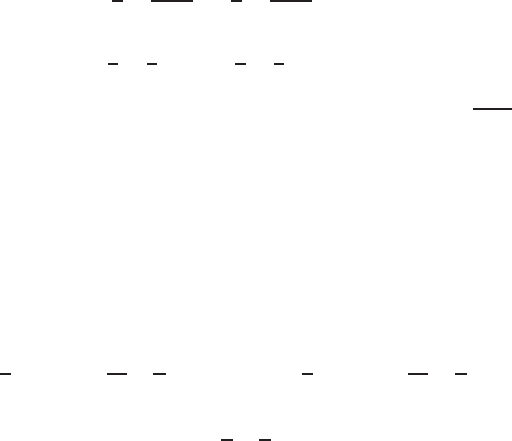
856 Chapter Nine /SOLUTIONS
38. The first smoothing gives
0,6,−6,6,−6,6, . . .
The second smoothing gives
3,0,2,−2,2,...
The smoothing process diminishes the peaks and valleys of this alternating sequence.
39. The first smoothing gives
0,0,6,6,6,0,0...
The second smoothing gives
0,2,4,6,4,2. . .
The smoothing process spreads out the spike at the fourth term to the neighboring terms.
40. The first smoothing gives
1.5,2,3,4,5,6,7...
The second smoothing gives
1.75,2.17,3,4,5,6. . .
Terms which are already the same as their average with their neighbors are not changed.
41. Each term is 2more than the previous term, so a recursive definition is sn=sn−1+ 2 for n > 1and s1= 1.
42. Each term is 2more than the previous term, so a recursive definition is sn=sn−1+ 2 for n > 1and s1= 2. Notice that
the even positive integers and odd positive integers have the same recursive definition except for the starting term.
43. Each term is twice the previous term minus one, so a recursive definition is sn= 2sn−1−1for n > 1and s1= 3. We
also notice that the differences of consecutive terms are powers of 2, so s2=s1+ 2,s3=s2+ 22, and so on. Thus
another recursive definition is sn=sn−1+ 2n−1for n > 1and s1= 3.
44. The differences between consecutive terms are 4,9,16,25, so, for example, s2=s1+4 and s3=s2+9. Thus, a possible
recursive definition is sn=sn−1+n2for n > 1and s1= 1.
45. The differences are 2,3,4,5, so, for example, s2=s1+ 2,s3=s2+ 3, and s4=s3+ 4. Thus, a recursive definition is
sn=sn−1+nfor n > 1and s1= 1.
46. The numerator and denominator of each term are related to the numerator and denominator of the previous term. The
denominator is the previous numerator and the numerator is the sum of the previous numerator and previous denominator.
For example, 5
3=2 + 3
3and 8
5=3 + 5
5.
If we simplify, we get 5
3=2
3+ 1,and 8
5=3
5+ 1.
In words, we turn the previous term upside down and add 1. Thus, a recursive definition is sn=1
sn−1
+ 1 for n > 1and
s1= 1.
47. For n > 1, if sn= 3n−2, then sn−1= 3(n−1) −2 = 3n−5, so
sn−sn−1= (3n−2) −(3n−5) = 3,
giving
sn=sn−1+ 3.
In addition, s1= 3 ·1−2 = 1.
48. For n > 1, if sn=n(n+ 1)/2, then sn−1= (n−1)(n−1 + 1)/2 = n(n−1)/2. Since
sn=1
2(n2+n) = n2
2+n
2and sn−1=1
2(n2−n) = n2
2−n
2,
we have
sn−sn−1=n
2+n
2=n,
so
sn=sn−1+n.
In addition, s1= 1(2)/2 = 1.

9.1 SOLUTIONS 857
49. For n > 1, if sn= 2n2−n, then sn−1= 2(n−1)2−(n−1) = 2n2−5n+ 3, so
sn−sn−1= (2n2−n)−(2n2−5n+ 3) = 4n−3,
giving
sn=sn−1+ 4n−3.
In addition, s1= 2 ·12−1 = 1.
50. The sequence seems to converge. By the 25th term it stabilizes to four decimal places at L= 0.7391.
51. The sequence oscillates up and down, but by the 20th term it stabilizes to 4 decimal places at L= 0.5671.
52. The sequence appears to be decreasing toward 0, but at a slower and slower rate. Even after 100 terms, it is hard to guess
what the series will eventually do. It can be shown that it converges to 0.
53. The sequence converges to 1. By the tenth term, it stabilizes to three decimal places at 1.000.
54. (a) Since month 10 is October, V10 is the number of SUVs sold in the US in October 2004.
(b) The difference Vn−Vn−1represents the increase in sales between month (n−1) and month n.
(c) The sum P12
i=1Virepresents the total sales of SUVs in the year 2004 (twelve months). The sum Pn
i=1 Virepresents
the total sales in the nmonths starting from January 1,2004.
55. (a) Since you have two parents and four grandparents, s1= 2 and s2= 4. In general, sn= 2n.
(b) Solving sn= 6 ·109gives
2n= 6 ·109
n=ln(6 ·109)
ln 2 = 32.482.
Thus, 33 or more generations ago, the number of ancestors is greater than the current population of the world. Since
the population of the world 33 generations ago was much smaller than it is now, there must have been overlap among
our ancestors.
56. In year 1, the payment is
p1= 10,000 + 0.05(100,000) = 15,000.
The balance in year 2is 100,000 −10,000 = 90,000, so
p2= 10,000 + 0.05(90,000) = 14,500.
The balance in year 3is 80,000, so
p3= 10,000 + 0.05(80,000) = 14,000.
Thus,
pn= 10,000 + 0.05(100,000 −(n−1) ·10,000)
= 15,500 −500n.
57. (a) The bottom row contains kcans, the next one contains (k−1) cans, then (k−2) and so on. Thus, there are krows.
Since the top row contains 1can, the second contains 2cans, etc, we have an=n.
(b) Since the nth row contains ncans, an=n,
Tn=Tn−1+an
gives
Tn=Tn−1+n, for n > 1.
In addition, T1= 1.
(c) If Tn=1
2n(n+ 1), then Tn−1=1
2(n−1)n, so
Tn−Tn−1=1
2n(n+ 1) −1
2n(n−1) = n
2(n+ 1 −(n−1)) = n.
In addition, T1=1
2·1(2) = 1.

858 Chapter Nine /SOLUTIONS
58. (a) In the first year, d1= 20,000(0.12), so the car’s value at the end of the first year is $20,000(0.88). In the second
year, d2= 20,000(0.88)(0.12), so the car’s value at the end of the second year is $20,000(0.88)2. Similarly,
d3= 20,000(0.88)2(0.12). In general
dn= 20,000(0.88)n−1(0.12).
(b) The first year r1= 400; the second year r2= 400(1.18), the third year r3= 400(1.18)2. In general, rn=
400(1.18)n−1.
(c) We have
Total cost =d1+d2+d3+r1+r2+r3
= 20,000(0.12)(1 + 0.88 + (0.88)2) + 400(1 + 1.18 + (1.18)2)
= 7799.52 dollars.
(d) A two-year old car has the same pattern of expenses except that the initial price is $20,000(0.88)2instead of $20,000
and that the repair costs start at $400(1.18)2instead of $400. Then
Total cost = 20,000(0.88)2(0.12)(1 + 0.88 + (0.88)2) + 400(1.18)2(1 + 1.18 + (1.18)2)
= 6923.05 dollars.
Thus, the two-year-old car costs you less and you should buy it.
59. (a) The first 12 terms are
1,1,2,3,5,8,13,21,34,55,89,144.
(b) The sequence of ratios is
1,2,3
2,5
3,8
5,13
8,21
13 ,34
21 ,55
34 ,89
55 ....
To three decimal places, the first ten ratios are
1,2,1.500,1.667,1.600,1.625,1.615,1.619,1.618,1.618.
It appears that the sequence of ratios is converging to r= 1.618. We find (1.618)2= 2.618 = 1.618 + 1 so
rseems to satisfy r2=r+ 1. Alternatively, by the quadratic formula, the positive root of x2−x−1 = 0 is
(1 + √5)/2 = 1.618.
(c) If we multiply both sides of the equation r2=r+ 1 by Arn−2, we obtain
Arn=Arn−1+Arn−2.
Thus, if sn=Arn, then sn−1=Arn−1and sn−2=Arn−2, so the sequence satisfies sn=sn−1+sn−2.
60. (a) Since 25/8 = 3 + 1/8, we have f(25/8) = 3 + (1 −1/8) = 3 + 7/8 = 31/8.
Since 13/9 = 1 + 4/9, we have f(13/9) = 1 + (1 −4/9) = 1 + 5/9 = 14/9.
Since π= 3 + (π−3), we have f(π) = 3 + (1 −(π−3)) = 7 −π.
(b) The terms are given by
s1= 1
s2=1
f(1) =1
1 + (1 −0) =1
2
s3=1
f(1/2) =1
0 + (1 −1/2) = 2
s4=1
f(2) =1
2 + (1 −0) =1
3
s5=1
f(1/3) =1
0 + (1 −1/3) =3
2
s6=1
f(3/2) =1
1 + (1 −1/2) =2
3.
The first six terms of the sequence are
1,1
2,2,1
3,3
2,2
3.

9.1 SOLUTIONS 859
61. We want to define lim
n→∞ sn=Lso that snis as close to Las we please for all sufficiently large n. Thus, the definition
says that for any positive ǫ, there is a value Nsuch that
|sn−L|< ǫ whenever n≥N.
62. We use Theorem 9.1, so we must show that snis bounded. Since tnconverges, it is bounded so there is a number M,
such that tn≤Mfor all n. Therefore sn≤tn≤Mfor all n. Since snis increasing, s1≤snfor all n. Thus if we let
K=s1, we have K≤sn≤Mfor all n, so snis bounded. Therefore, snconverges.
Strengthen Your Understanding
63. A decreasing sequence does not have to converge to 0; in fact, it does not have to converge at all (consider the sequence
sn=−n, for example). In this case, the limit of the sequence is
lim
n→∞
3n+ 10
7n+ 3 = lim
n→∞
3 + 10/n
7 + 3/n =3 + 0
7 + 0 =3
7.
64. Even though each term of the sequence is greater than 2, the terms could be getting progressively closer to 2and the limit
could equal 2. For example, consider the sequence
sn= 2 + 1
n.
The limit of this sequence is
lim
n→∞ 2 + 1
n= 2 + 0 = 2.
Thus, the limit of the sequence could be 2.
65. Since we want our sequence to be increasing and converging to 0, all of the terms of the sequence must be negative. So
we need to find a sequence whose terms are negative and approaching zero. An example is sn=−1/n.
66. One example is the sequence sn=n. This sequence is increasing and therefore monotone, but it does not converge
because the terms do not get closer and closer to any specific finite value.
67. False. The first 1000 terms could be the same for two different sequences and yet one sequence converges and the other
diverges. For example, sn= 0 for all nis a convergent sequence, but
tn=n0ifn≤1000
nif n > 1000
is a divergent sequence.
68. False. The limit could be zero. For example, sn= 1/n is a convergent sequence of positive terms and lim
n→∞ sn= 0.
69. True. If there is no term greater than a million, then the sequence is bounded by 0< sn<106for all n.
70. True. If there is only a finite number of terms greater than a million, then we can choose the largest of them to be an upper
bound Mfor the sequence. Thus the sequence is bounded by 0< sn≤Mfor all n.
71. False. The terms sntend to the limit of the sequence which may not be zero. For example, sn= 1 + 1/n is a convergent
sequence and sntends to 1 as nincreases.
72. False. For example the sequence −2,−1,0,1,2,3, . . . with sn=n−3is monotone increasing and has both positive and
negative terms.
73. True. If a monotone sequence does not converge, then it is unbounded. If moreover the sequence contains only positive
terms then it is bounded below by zero. Thus it is not bounded above, and in particular it is not bounded above by a
million.
74. False. The decreasing sequence −1,−2,−3,... has all terms less than a million, but it has no lower bound. Thus it is
unbounded.
75. (b). Sequence (I) is monotone increasing, bounded between 9 and 10.
Sequence (II) is monotone decreasing and bounded between 10 and 11.
Sequence (III) is bounded between −1and 1 but it is not monotone because it begins 0.54,−0.42,−0.99,−0.65, . . .,
which contains both a jump down, from 0.54 to −0.42 and a jump up, from −0.99 to −0.65. Terms in a monotone
sequence always jump in the same direction.
Sequence (IV) is monotone increasing but is not bounded.
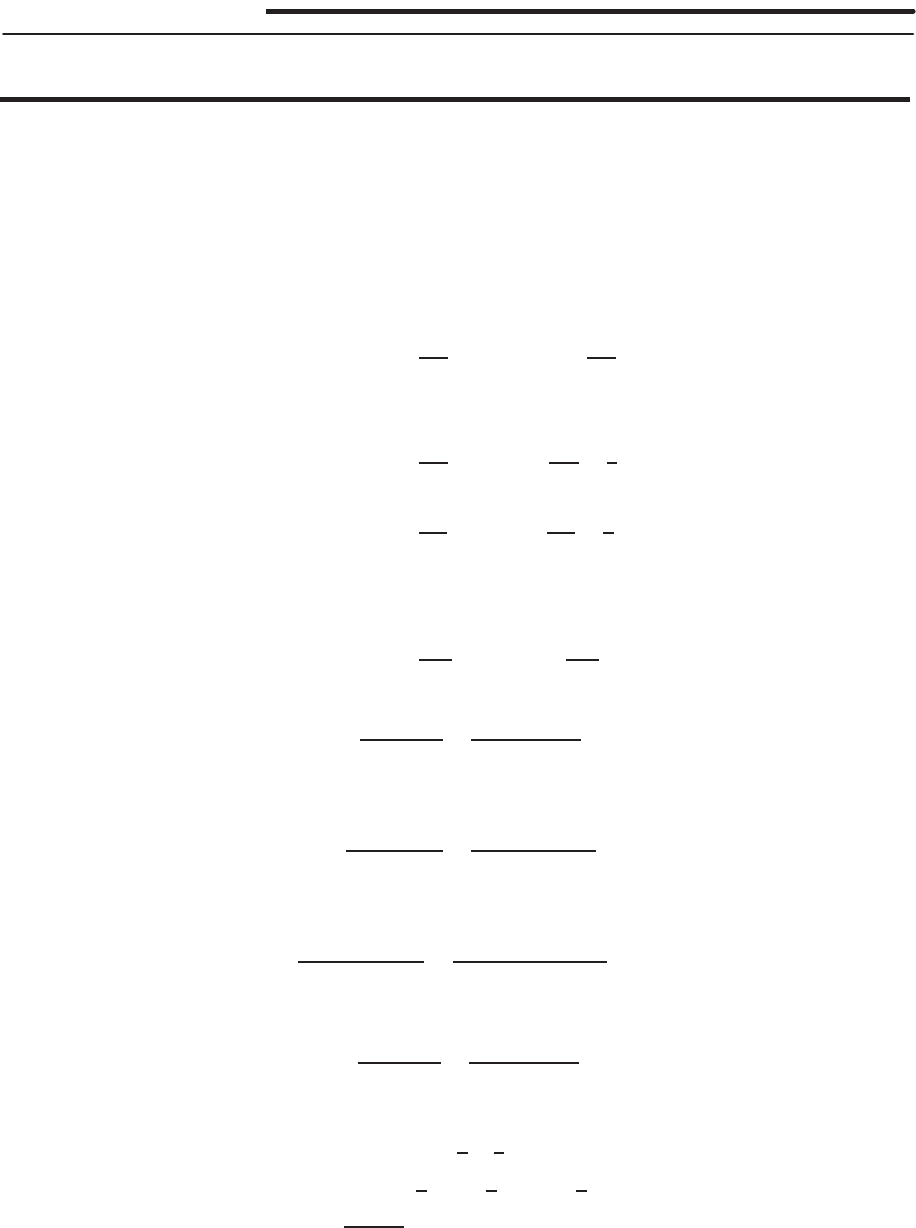
860 Chapter Nine /SOLUTIONS
Solutions for Section 9.2
Exercises
1. Sequence, because the terms are not added together.
2. Series, because the terms are added together.
3. Sequence, because the terms are not added together.
4. Sequence, because the terms are not added together.
5. Series, because the terms are added together.
6. Series, because the terms are added together.
7. Series, because the terms are added together.
8. Yes, a= 5, ratio =−2.
9. No. Ratio between successive terms is not constant: 1/3
1/2= 0.66 ..., while 1/4
1/3= 0.75.
10. Yes, a= 2, ratio = 1/2.
11. Yes, a= 1, ratio =−1/2.
12. No. Ratio between successive terms is not constant: 2x2
x= 2x, while 3x3
2x2=3
2x.
13. Yes, a= 1, ratio = 2z.
14. No. Ratio between successive terms is not constant: 6z2
3z= 2z, while 9z3
6z2=3
2z.
15. Yes, a= 1, ratio =−x.
16. Yes, a= 1, ratio =−y2.
17. Yes, a=y2, ratio =y.
18. No. Ratio between successive terms is not constant: −z4
z2=−z2, while z8
−z4=−z4.
19. The series has 26 terms. The first term is a= 2 and the constant ratio is x= 0.1, so
Sum =a(1 −x26)
(1 −x)=2(1 −(0.1)26)
0.9= 2.222.
20. The series has 10 terms. The first term is a= 0.2and the constant ratio is x= 0.1, so
Sum =0.2(1 −x10)
(1 −x)=0.2(1 −(0.1)10)
0.9= 0.222.
21. The series has 9 terms. The first term is a= 0.00002 and the constant ratio is x= 0.1, so
Sum =0.00002(1 −x9)
(1 −x)=0.00002(1 −(0.1)9)
0.9= 0.0000222.
22. The series has 14 terms. The first term is a= 8 and the constant ratio is x= 1/2 = 0.5, so
Sum =8(1 −x14)
(1 −x)=8(1 −(0.5)14)
0.5= 15.999
23. We have
Sum = 36 + 12 + 4 + 4
3+4
9+···
= 36 + 36 ·1
3+ 36 1
32
+ 36 1
33
+···
=36
1−1/3= 54.
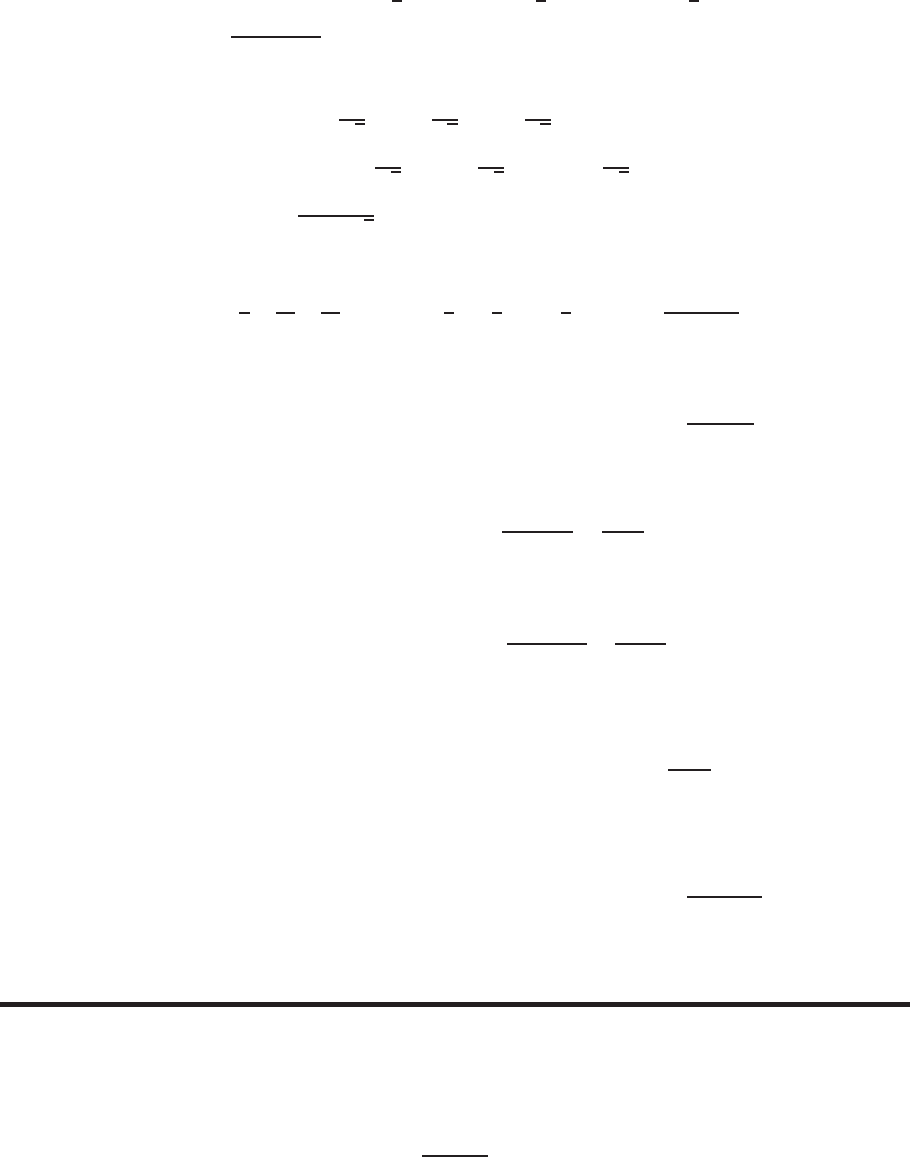
9.2 SOLUTIONS 861
24. We have
Sum =−810 + 540 −360 + 240 −160 + ···
=−810 + (−810) ·−2
3+ (−810) ·−2
32
+(−810) ·−2
33
+···
=−810
1−(−2/3) =−486.
25. We have
Sum = 80 + 80
√2+ 40 + 40
√2+ 20 + 20
√2+···
= 80 + 80 1
√2+ 80 1
√22
+ +80 1
√23
+···
=80
1−1/√2= 273.137.
26. This is a geometric series with first term 1and ratio z/2:
1 + z
2+z2
4+z3
8+··· = 1 + z
2+z
22
+z
23
+··· =1
1−(z/2) .
This series converges for |z/2|<1, that is for −2< z < 2.
27. This is a geometric series with first term 1and ratio 3x:
1 + 3x+ 9x2+ 27x3+···= 1 + (3x) + (3x)2+ (3x)3+···=1
1−(3x).
This series converges for |3x|<1, that is for −1/3< x < 1/3.
28. This is a geometric series with first term yand ratio −y:
y−y2+y3−y4+··· =y
1−(−y)=y
1 + y.
This series converges for | − y|<1, that is for −1< y < 1.
29. This is a geometric series with first term 2and ratio −2z,
2−4z+ 8z2−16z3+···=2
1−(−2z)=2
1 + 2z.
This series converges for | − 2z|<1, that is for −1/2< z < 1/2.
30. We can rewrite the series as 3 + (x+x2+x3+···). The terms after the first term define a geometric series with first
term xand ratio x. Therefore, we have
3 + x+x2+x3+···= 3 + (x+x2+x3+···) = 3 + x
1−x.
This series converges for |x|<1, that is for −1< x < 1.
31. We can rewrite the series as 4 + (y+y2/3 + y3/9 + ···). The terms after the first term define a geometric series with
first term yand ratio y/3. Therefore, we have
4 + y+y2/3 + y3/9 + ···= 4 + (y+y2/3 + y3/9 + ···) = 4 + y
1−(y/3) .
This series converges for |y/3|<1, that is for −3< y < 3.
Problems
32. Since the amount of ampicillin excreted during the time interval between tablets is 250 mg, we have
Amount of ampicillin excreted =Original quantity −Final quantity
250 = Q−(0.04)Q.
Solving for Qgives, as before,
Q=250
1−0.04 ≈260.42.

862 Chapter Nine /SOLUTIONS
33. (a)
P1= 0
P2= 250(0.04)
P3= 250(0.04) + 250(0.04)2
P4= 250(0.04) + 250(0.04)2+ 250(0.04)3
.
.
.
Pn= 250(0.04) + 250(0.04)2+ 250(0.04)3+···+ 250(0.04)n−1
(b) Pn= 250(0.04) 1 + (0.04) + (0.04)2+ (0.04)3+··· + (0.04)n−2= 250 0.04(1 −(0.04)n−1)
1−0.04
(c)
P= lim
n→∞ Pn
= lim
n→∞ 250 0.04(1 −(0.04)n−1)
1−0.04
=(250)(0.04)
0.96 = 0.04Q≈10.42
Thus, lim
n→∞ Pn= 10.42 and lim
n→∞ Qn= 260.42. We would expect these limits to differ because one is right
before taking a tablet, one is right after. We would expect the difference between them to be 250 mg, the amount of
ampicillin in one tablet.
34. (a) The quantity of atenolol in the blood is given by Q(t) = Q0e−kt, where Q0=Q(0) and kis a constant. Since the
half-life is 6.3 hours, 1
2=e−6.3k, k =−1
6.3ln 1
2≈0.11.
After 24 hours
Q=Q0e−k(24) ≈Q0e−0.11(24) ≈Q0(0.07).
Thus, the percentage of the atenolol that remains after 24 hours ≈7%.
(b)
Q0= 50
Q1= 50 + 50(0.07)
Q2= 50 + 50(0.07) + 50(0.07)2
Q3= 50 + 50(0.07) + 50(0.07)2+ 50(0.07)3
.
.
.
Qn= 50 + 50(0.07) + 50(0.07)2+···+ 50(0.07)n=50(1 −(0.07)n+1 )
1−0.07
(c)
P1= 50(0.07)
P2= 50(0.07) + 50(0.07)2
P3= 50(0.07) + 50(0.07)2+ 50(0.07)3
P4= 50(0.07) + 50(0.07)2+ 50(0.07)3+ 50(0.07)4
.
.
.
Pn= 50(0.07) + 50(0.07)2+ 50(0.07)3+···+ 50(0.07)n
= 50(0.07) 1 + (0.07) + (0.07)2+···+ (0.07)n−1=0.07(50)(1 −(0.07)n)
1−0.07
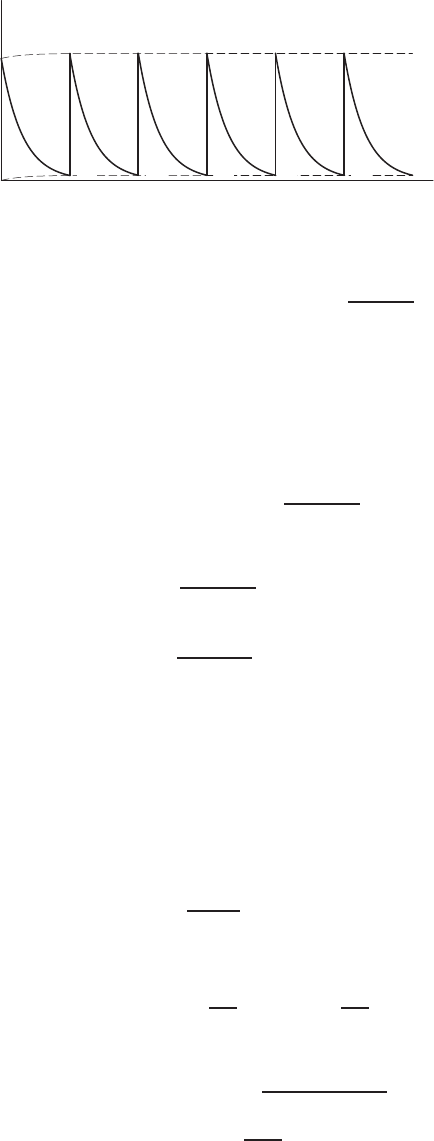
9.2 SOLUTIONS 863
35.
125
Q0=
250
123456
t
(time,
days)
q
(quantity, mg)
Q1Q2Q3Q4Q5
P1P2P3P4P5
36. Let nbe the number of days elapsed. As n→ ∞, the amount of pollutants right after a dump is given by the sum of an
infinite geometric series:
B= 8 + 8(0.75) + 8(0.75)2+ 8(0.75)3+···=8
1−0.75 = 32.
Thus, the level of pollutants in the bay approaches 32 tons over time.
37. (a) In the first year, consumption is 25 million tons. In the second year this grows to 25(1.01) million tons, and in
subsequent years the consumption grows by a factor of 1.01.During the next nyears
Total consumption = 25 + 25(1.01) + 25(1.01)2+···25(1.01)n−1million tons.
This is a geometric series with a= 25 and x= 1.01,thus we have
Total consumption = 25 1.01n−1
1.01 −1.
The reserves are exhausted when the total consumption reaches 400 so we find nby solving the equation
25 1.01n−1
1.01 −1= 400.
Simplifying, gives
1.01n−1
0.01 = 16
so
1.01n−1 = 0.16
and
1.01n= 1.16.
Taking natural logs of both sides gives
ln 1.01n= ln 1.16
so
nln 1.01 = ln 1.16
and
n=ln 1.16
ln 1.01 = 14.916.
The reserves are exhausted after 15 years.
(b) If an r% annual reduction is imposed then
Total consumption = 25 + 25 1−r
100 + 25 1−r
100 2
+···million tons.
This is an infinite geometric series with a= 25 and x= 1 −r/100,thus we have
Total consumption = 25 1
1−(1 −r/100)
=2500
r.
For existing reserves never to be exhausted, we need 2500/r < 400, which gives r > 6.25%. Consumption must be
reduced by at least 6.25% annually.

864 Chapter Nine /SOLUTIONS
38.
Total present value, in dollars = 1000 + 1000e−0.01 + 1000e−0.01(2) + 1000e−0.01(3) +···
= 1000 + 1000(e−0.01) + 1000(e−0.01 )2+ 1000(e−0.01 )3+···
This is an infinite geometric series with a= 1000 and x=e(−0.01), and sum
Total present value, in dollars =1000
1−e−0.01 = 100,500.833.
39. (a) (i) On the night of December 31, 1999:
First deposit will have grown to 2(1.04)7million dollars.
Second deposit will have grown to 2(1.04)6million dollars.
···
Most recent deposit (Jan.1, 1999) will have grown to 2(1.04) million dollars.
Thus
Total amount = 2(1.04)7+ 2(1.04)6+···+ 2(1.04)
= 2(1.04)(1 + 1.04 + ···+ (1.04)6
|{z }
finite geometric series
)
= 2(1.04) 1−(1.04)7
1−1.04
= 16.43 million dollars.
(ii) Notice that if 10 payments were made, there are 9 years between the first and the last. On the day of the last
payment:
First deposit will have grown to 2(1.04)9million dollars.
Second deposit will have grown to 2(1.04)8million dollars.
···
Last deposit will be 2 million dollars.
Therefore
Total amount = 2(1.04)9+ 2(1.04)8+···+ 2
= 2(1 + 1.04 + (1.04)2+··· + (1.04)9
|{z }
finite geometric series
)
= 2 1−(1.04)10
1−1.04
= 24.01 million dollars.
(b) In part (a) (ii) we found the future value of the contract 9 years in the future. Thus
Present Value =24.01
(1.04)9= 16.87 million dollars.
Alternatively, we can calculate the present value of each of the payments separately:
Present Value = 2 + 2
1.04 +2
(1.04)2+···+2
(1.04)9
= 2 1−(1/1.04)10
1−1/1.04 = 16.87 million dollars.
Notice that the present value of the contract ($16.87 million) is considerably less than the face value of the contract,
$20 million.

9.2 SOLUTIONS 865
40. The first $200 is invested for 24 months so it has a future value of $200(1 + 0.5/100)24 = $200 ·1.00524 . The second
installment has a future value of $ 200 ·1.00523 ,since it is invested for only 23 months. The final installment, paid after
23 months, has a future value of $ 200 ·1.005.So,
Total investment = 200 ·1.00524 + 200 ·1.00523 +. . . + 200 ·1.005
= 200 ·1.005 1.00523 + 1.00522 +. . . + 1
= 200 ·1.005 1−1.00524
1−1.005
= 200 ·1.005 ·25.432
= $5111.82.
41. To get $20,000 the day he retires he needs to invest a present value Psuch that P(1 + 5/100)20 = $20,000.Solving for
Pgives the present value P= $20,000 ·1.05−20 .To fund the second payment he needs to invest $ 20,000 ·1.05−21 ,and
so on. To fund the payment 10 years after his retirement he needs to invest $ 20,000 ·1.05−30 .There are 11 payments in
all, so
Total investment = 20,000 ·1.05−20 + 20,000 ·1.05−21 +...+ 20,000 ·1.05−30
= 20,000 ·1.05−20 1 + 1.05−1+...+ 1.05−10
= 20,000 ·1.05−20 1−1.05−11
1−1.05−1
= 20,000 ·1.05−20 ·8.7217
= $65,742.60.
42. If the half-life is Thours, then the exponential decay formula Q=Q0e−kt gives k= ln 2/T . If we start with Q0= 1
tablet, then the amount of drug present in the body after 5Thours is
Q=e−5kT =e−5 ln 2 = 0.03125,
so 3.125% of a tablet remains. Thus, immediately after taking the first tablet, there is one tablet in the body. Five half-lives
later, this has reduced to 1·0.03125 = 0.03125 tablets, and immediately after the second tablet there are 1 + 0.03125
tablets in the body. Continuing this forever leads to
Number of tablets in body = 1 + 0.03125 + (0.03125)2+···+ (0.03125)n+···.
This is an infinite geometric series, with common ratio x= 0.03125, and sum 1/(1 −x). Thus
Number of tablets in body =1
1−0.03125 = 1.0323.
43. The amount of additional income generated directly by people spending their extra money is $100(0.8) = $80 million.
This additional money in turn is spent, generating another ($100(0.8)) (0.8) = $100(0.8)2million. This continues
indefinitely, resulting in
Total additional income = 100(0.8) + 100(0.8)2+ 100(0.8)3+··· =100(0.8)
1−0.8= $400 million
44. (a)
Present value of first coupon =50
1.05
Present value of second coupon =50
(1.05)2,etc.
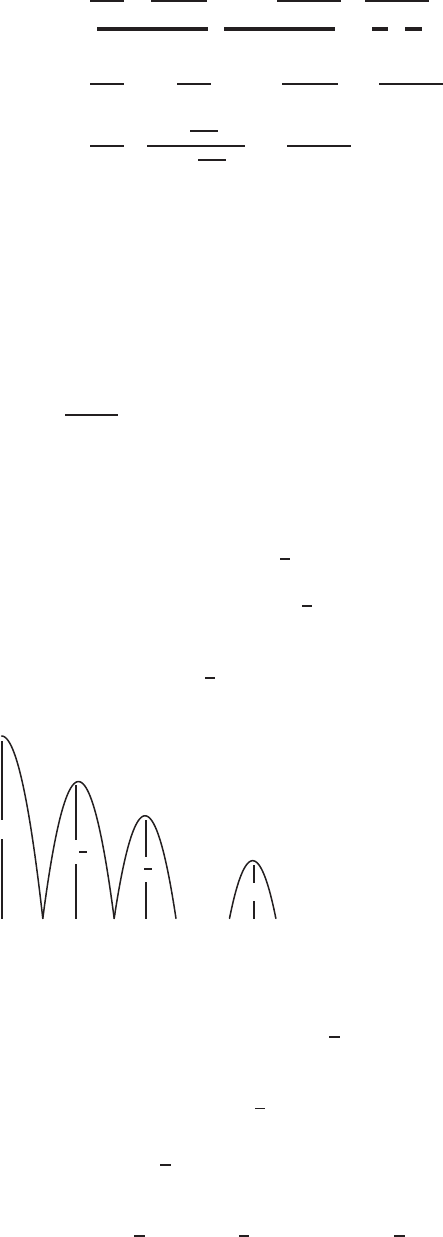
866 Chapter Nine /SOLUTIONS
Total present value =50
1.05 +50
(1.05)2+··· +50
(1.05)10
| {z }
coupons
+1000
(1.05)10
| {z }
principal
=50
1.05 1 + 1
1.05 +··· +1
(1.05)9+1000
(1.05)10
=50
1.05 1−1
1.05 10
1−1
1.05 !+1000
(1.05)10
= 386.087 + 613.913
= $1000
(b) When the interest rate is 5%, the present value equals the principal.
(c) When the interest rate is more than 5%, the present value is smaller than it is when interest is 5% and must therefore
be less than the principal. Since the bond will sell for around its present value, it will sell for less than the principal;
hence the description trading at discount.
(d) When the interest rate is less than 5%, the present value is more than the principal. Hence the bond will be selling for
more than the principal, and is described as trading at a premium.
45. The total of the spending and respending of the additional income is given by the series: Total additional income =
100(0.9) + 100(0.9)2+ 100(0.9)3+··· =100(0.9)
1−0.9= $900 million.
Notice the large effect of changing the assumption about the fraction of money spent has: the additional spending more
than doubles.
46. (a) Let hnbe the height of the nth bounce after the ball hits the floor for the nth time. Then from Figure 9.1,
h0=height before first bounce = 10 feet,
h1=height after first bounce = 10 3
4feet,
h2=height after second bounce = 10 3
42
feet.
Generalizing gives
hn= 10 3
4n
.
✻
❄
10
✻
❄
10( 3
4)
✻
❄
10( 3
4)2✻
❄
hn
··· ···
Figure 9.1
(b) When the ball hits the floor for the first time, the total distance it has traveled is just D1= 10 feet. (Notice that this
is the same as h0= 10.) Then the ball bounces back to a height of h1= 10 3
4, comes down and hits the floor for
the second time. See Figure 9.1. The total distance it has traveled is
D2=h0+ 2h1= 10 + 2 ·10 3
4= 25 feet.
Then the ball bounces back to a height of h2= 10 3
42
, comes down and hits the floor for the third time. It has
traveled
D3=h0+ 2h1+ 2h2= 10 + 2 ·10 3
4+ 2 ·10 3
42
= 25 + 2 ·10 3
42
= 36.25 feet.
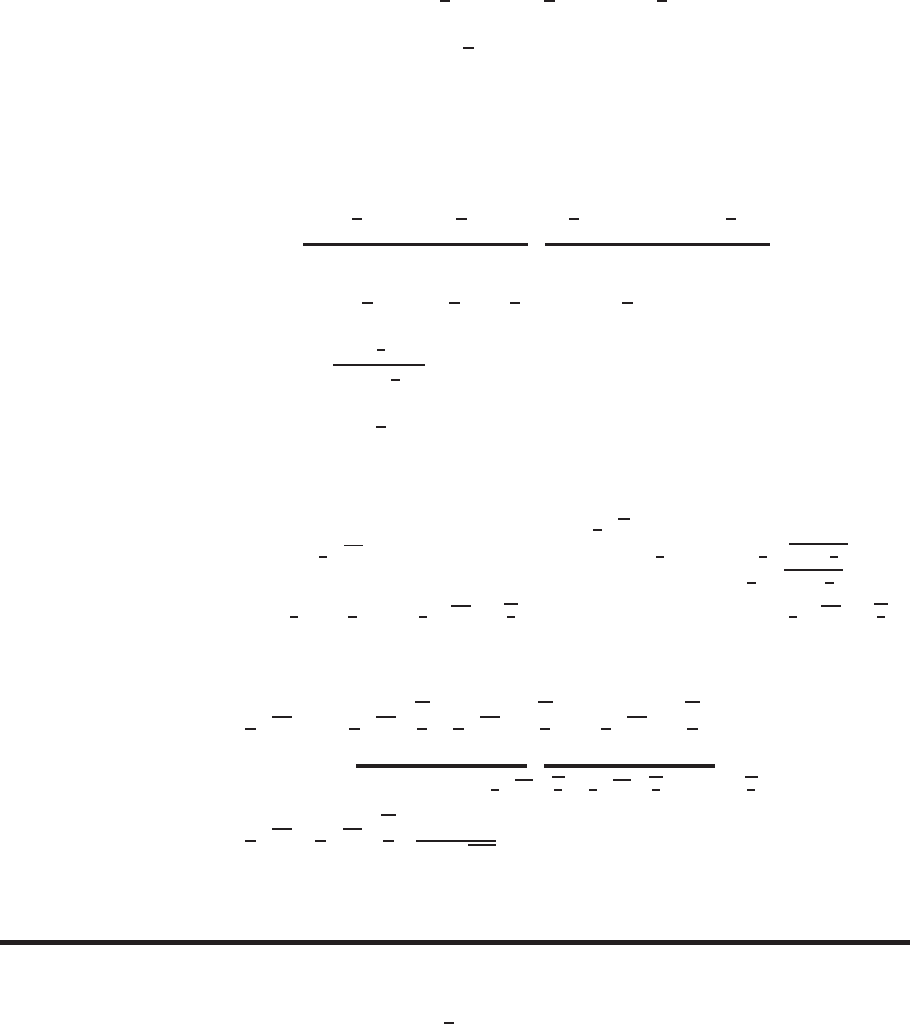
9.2 SOLUTIONS 867
Similarly,
D4=h0+ 2h1+ 2h2+ 2h3
= 10 + 2 ·10 3
4+ 2 ·10 3
42
+2·10 3
43
=36.25 + 2 ·10 3
43
≈44.69 feet.
(c) When the ball hits the floor for the nth time, its last bounce was of height hn−1. Thus, by the method used in part
(b), we get
Dn=h0+ 2h1+ 2h2+ 2h3+· ·· + 2hn−1
= 10 + 2 ·10 3
4+ 2 ·10 3
42
+ 2 ·10 3
43
+··· + 2 ·10 3
4n−1
| {z }
finite geometric series
= 10 + 2 ·10·3
41 + 3
4+3
42
+··· +3
4n−2
= 10 + 15 1−3
4n−1
1−3
4!
= 10 + 60 1−3
4n−1.
47. (a) The acceleration of gravity is 32 ft/sec2so acceleration = 32 and velocity v= 32t+C. Since the ball is dropped,
its initial velocity is 0so v= 32t. Thus the position is s= 16t2+C. Calling the initial position s= 0, we have
s= 6t. The distance traveled is hso h= 16t. Solving for twe get t=1
4√h.
(b) The first drop from 10 feet takes 1
4√10 seconds. The first full bounce (to 10 ·(3
4) feet) takes 1
4p10 ·(3
4)seconds
to rise, therefore the same time to come down. Thus, the full bounce, up and down, takes 2( 1
4)p10 ·(3
4)seconds.
The next full bounce takes 2( 1
4)10 ·(3
4)2= 2( 1
4)√10 p3
42
seconds. The nth bounce takes 2( 1
4)√10 p3
4n
seconds. Therefore the
Total amount of time
=1
4√10 + 2
4√10r3
4+2
4√10 r3
4!2
+2
4√10 r3
4!3
| {z }
Geometric series with a=2
4√10p3
4=1
2√10p3
4and x=p3
4
+···
=1
4√10 + 1
2√10r3
4 1
1−p3/4!seconds.
Strengthen Your Understanding
48. The formula 4/(1 −1/4) used is for computing the sum of a geometric series, not the limit of a sequence. The sequence
is given by the formula
sn= 4 1
4n−1
, n ≥1,
so since (1/4) is between 0 and 1, the sequence converges to 0.
49. The formula for the sum of an infinite geometric series does not apply because the common ratio is not between −1and
1.
50. If the common ratio, x, of a geometric series satisfies |x| ≥ 1then the series diverges. If x= 3 then the series 3 + 6 +
12 + 24 + ···diverges.
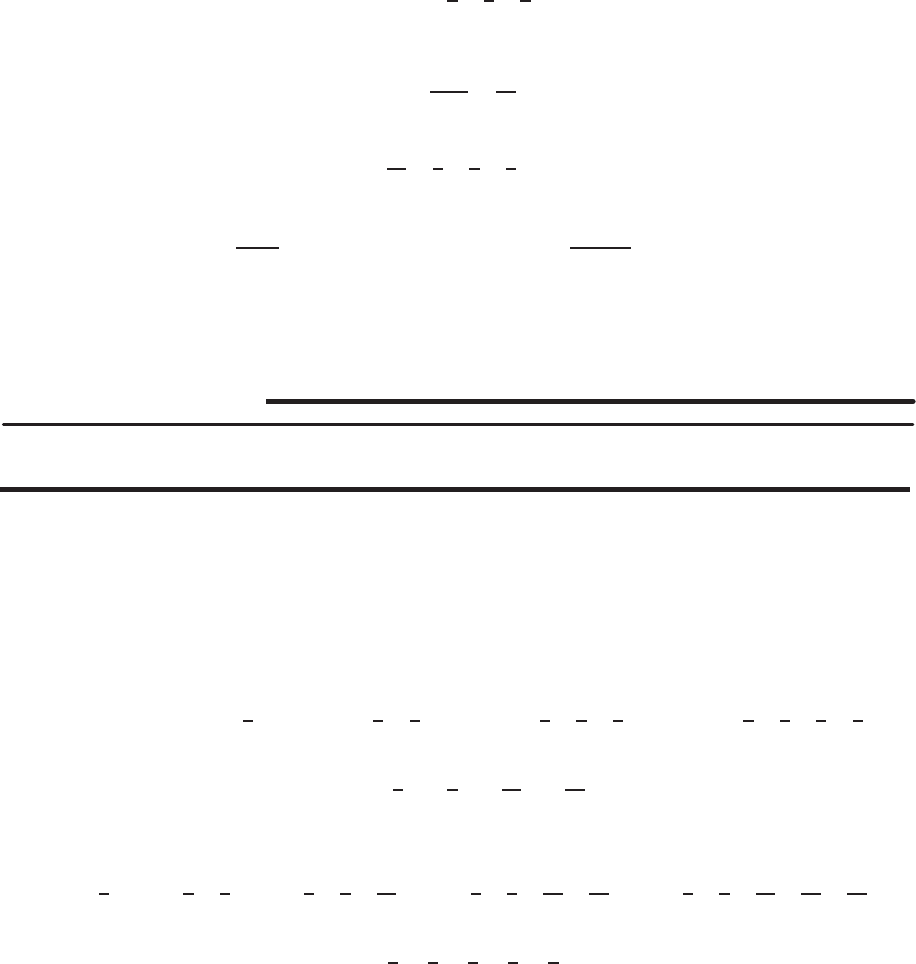
868 Chapter Nine /SOLUTIONS
51. Two possible examples are the series 1+1+1+1+. . ., which has common ratio 1, and the series 1+(−1)+1+(−1)+. . .,
which has common ratio −1.
52. One way to find an example is to start with a geometric series with four distinct terms, and then rescale the terms so that
their sum is 10.
For example, we might start with the series
1 + 1
2+1
4+1
8,
whose sum is 15/8. Since we want a sum of 10, we scale these terms up by a factor of
10
15/8=16
3.
This gives the series 16
3+8
3+4
3+2
3= 10.
This series is geometric with common ratio 1/2.
53. We know that ∞
X
n=0
axn=a
1−xfor |x|<1. Letting x= 1/2we have a
1−1/2= 2a. Thus a= 5 gives a limit of 10
for the geometric series.
54. (c). The common ratio in series (I) and (IV) is between −1and 1. The common ratio in (II) and (III) is greater than one.
Solutions for Section 9.3
Exercises
1. The series is 1 + 2 + 3 + 4 + 5 + ···. The sequence of partial sums is
S1= 1, S2= 1 + 2, S3= 1 + 2 + 3, S4= 1 + 2 + 3 + 4, S5= 1 + 2 + 3 + 4 + 5,...
which is
1,3,6,10,15 ....
2. The series is −1 + 1/2−1/3 + 1/4−1/5 + ···. The sequence of partial sums is
S1=−1, S2=−1 + 1
2, S3=−1 + 1
2−1
3, S4=−1 + 1
2−1
3+1
4, S5=−1 + 1
2−1
3+1
4−1
5,...
which is
−1,−1
2,−5
6,−7
12 ,−47
60 ,....
3. The series is 1/2 + 1/6 + 1/12 + 1/20 + 1/30 + ···. The sequence of partial sums is
S1=1
2, S2=1
2+1
6, S3=1
2+1
6+1
12 , S4=1
2+1
6+1
12 +1
20 , S5=1
2+1
6+1
12 +1
20 +1
30 ,...
which is 1
2,2
3,3
4,4
5,5
6.

9.3 SOLUTIONS 869
4. We use the integral test to determine whether this series converges or diverges. To do so we determine whether the
corresponding improper integral Z∞
1
1
(x+ 2)2dx converges or diverges:
Z∞
1
1
(x+ 2)2dx = lim
b→∞ Zb
1
1
(x+ 2)2dx
= lim
b→∞ Zb
3
1
w2dw (Substitute w=x+ 2)
= lim
b→∞ −1
w
b
3
= lim
b→∞ −1
b+1
3=1
3.
Since the integral Z∞
1
1
(x+ 2)2dx converges, we conclude from the integral test that the series ∞
X
n=1
1
(n+ 2)2converges.
5. We use the integral test with f(x) = x/(x2+ 1) to determine whether this series converges or diverges. We determine
whether the corresponding improper integral Z∞
1
x
x2+ 1 dx converges or diverges:
Z∞
1
x
x2+ 1 dx = lim
b→∞ Zb
1
x
x2+ 1 dx = lim
b→∞
1
2ln(x2+ 1)
b
1
= lim
b→∞ 1
2ln(b2+ 1) −1
2ln 2=∞.
Since the integral Z∞
1
x
x2+ 1 dx diverges, we conclude from the integral test that the series
∞
X
n=1
n
n2+ 1 diverges.
6. We use the integral test with f(x) = 1/exto determine whether this series converges or diverges. To do so we determine
whether the corresponding improper integral Z∞
1
1
exdx converges or diverges:
Z∞
1
1
exdx = lim
b→∞ Zb
1
e−xdx = lim
b→∞ −e−x
b
1
= lim
b→∞ −e−b+e−1=e−1.
Since the integral Z∞
1
1
exdx converges, we conclude from the integral test that the series
∞
X
n=1
1
enconverges. We can also
observe that this is a geometric series with ratio x= 1/e < 1, and hence it converges.
7. We use the integral test with f(x) = 1/(x(ln x)2)to determine whether this series converges or diverges. We determine
whether the corresponding improper integral Z∞
2
1
x(ln x)2dx converges or diverges:
Z∞
2
1
x(ln x)2dx = lim
b→∞ Zb
2
1
x(ln x)2dx = lim
b→∞ −1
ln x
b
2
= lim
b→∞ −1
ln b+1
ln 2 =1
ln 2 .
Since the integral Z∞
2
1
x(ln x)2dx converges, we conclude from the integral test that the series
∞
X
n=2
1
n(ln n)2converges.
8. The improper integral Z∞
1
x−3dx converges to 1
2, since
Zb
1
x−3dx =x−2
−2
b
1
=b−2
−2−1−2
−2=1
−2b2+1
2
and
lim
b→∞ 1
−2b2+1
2=1
2.
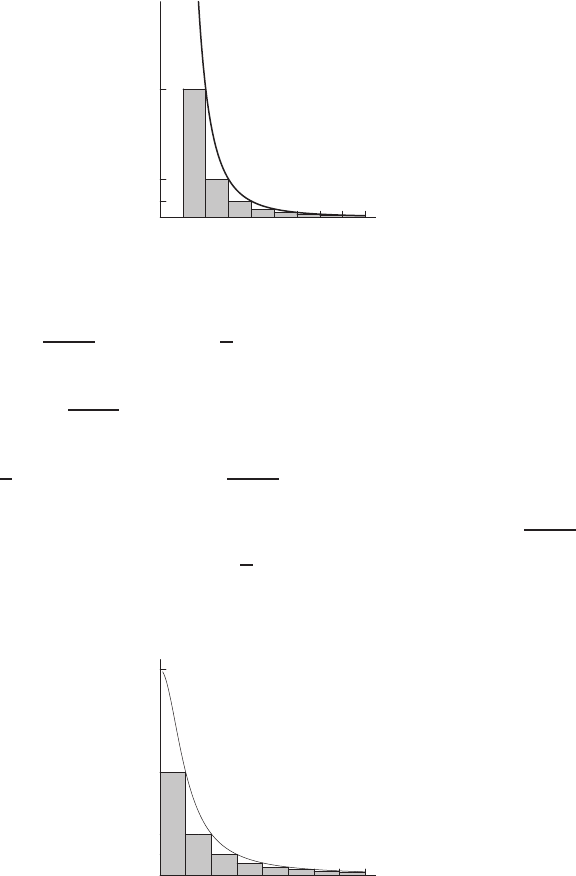
870 Chapter Nine /SOLUTIONS
The terms of the series
∞
X
n=2
n−3form a right hand sum for the improper integral; each term represents the area of a
rectangle of width 1 fitting completely under the graph of the function x−3. (See Figure 9.2.) Thus the sequence of partial
sums is bounded above by 1/2.Since the partial sums are increasing (every new term added is positive) the series is
guaranteed to converge to some number less than or equal to 1/2by Theorem 9.1.
1 2 3 4 5 6 7 8 9
1/8
1/27
1/64 x
y
y= 1/x3
Figure 9.2
9. The improper integral Z∞
0
1
x2+ 1 dx converges to π
2,since
Zb
0
1
x2+ 1 dx = arctan x|b
0= arctan b−arctan 0 = arctan b,
and lim
b→∞ arctan b=π
2.The terms of the series
∞
X
n=1
1
n2+ 1 form a right hand sum for the improper integral; each term
represents the area of a rectangle of width 1 fitting completely under the graph of the function 1
x2+ 1 . (See Figure 9.3.)
Thus the sequence of partial sums is bounded above by π
2.Since the partial sums are increasing (every new term added is
positive), the series is guaranteed to converge to some number less than or equal to π/2by Theorem 9.1.
12345678
1/10
1/5
1/2
1
x
y
y= 1/(x2+ 1)
Figure 9.3
10. The integral test requires that f(x) = x2, which is not decreasing.
11. The integral test requires that f(x) = (−1)x/x. However (−1)xis not defined for all x.
12. The integral test requires that f(x) = e−xsin x, which is not positive, nor is it decreasing.

9.3 SOLUTIONS 871
Problems
13. Using the integral test, we compare the series with
Z∞
0
3
x+ 2 dx = lim
b→∞ Zb
0
3
x+ 2 dx = 3 ln |x+ 2|
b
0
.
Since ln(b+ 2) is unbounded as b→ ∞, the integral diverges and therefore so does the series.
14. Since the terms in the series are positive and decreasing, we can use the integral test. We calculate the corresponding
improper integral:
Z∞
0
4
2x+ 1 dx = lim
b→∞ Zb
0
4
2x+ 1 dx = lim
b→∞ 2 ln(2x+ 1)
b
0
= lim
b→∞ 2 ln(2b+ 1).
Since the limit does not exist, the integral diverges, so the series
∞
X
n=0
4
2n+ 1 diverges.
15. We use the integral test and calculate the corresponding improper integral, R∞
02/√2 + x dx:
Z∞
0
2
√2 + xdx = lim
b→∞ Zb
0
2dx
√2 + x= lim
b→∞ 4(2 + x)1/2
b
0
= lim
b→∞ 4(2 + b)1/2−21/2.
Since the limit does not exist, the integral diverges, so the series
∞
X
n=1
2
√2 + ndiverges.
16. Since the terms in the series are positive and decreasing, we can use the integral test. We calculate the corresponding
improper integral using the substitution w=x2
Z∞
0
2x
1 + x4dx = lim
b→∞ Zb
0
2x
1 + x4dx = lim
b→∞ arctan x2
b
0
= lim
b→∞ arctan b2=π
2.
Since the limit exists, the integral converges, so the series
∞
X
n=0
2n
1 + n4converges.
17. Since the terms in the series are positive and decreasing, we can use the integral test. We calculate the corresponding
improper integral using the substitution w= 1 + x2:
Z∞
0
2x
(1 + x2)2dx = lim
b→∞ Zb
0
2x
(1 + x2)2dx = lim
b→∞ −1
(1 + x2)
b
0
= lim
b→∞ −1
1 + b2+ 1= 1.
Since the limit exists, the integral converges, so the series ∞
X
n=0
2n
(1 + n2)2converges.
18. The terms in this series do not tend to 0. We have
lim
n→∞
2n
√4 + n2= lim
n→∞
2
p4/n2+ 1 = 2.
Thus the series diverges. It is also possible (although much slower) to use the integral test. We calculate the corresponding
improper integral using the substitution w=x2
Z∞
0
2x
√4 + x2dx = lim
b→∞ Zb
0
2x
√4 + x2dx = lim
b→∞ 2p4 + x2
b
0
= lim
b→∞(2p4 + b2−4).
Since the limit does not exist, the integral diverges, so the series
∞
X
n=0
2n
√4 + n2diverges.
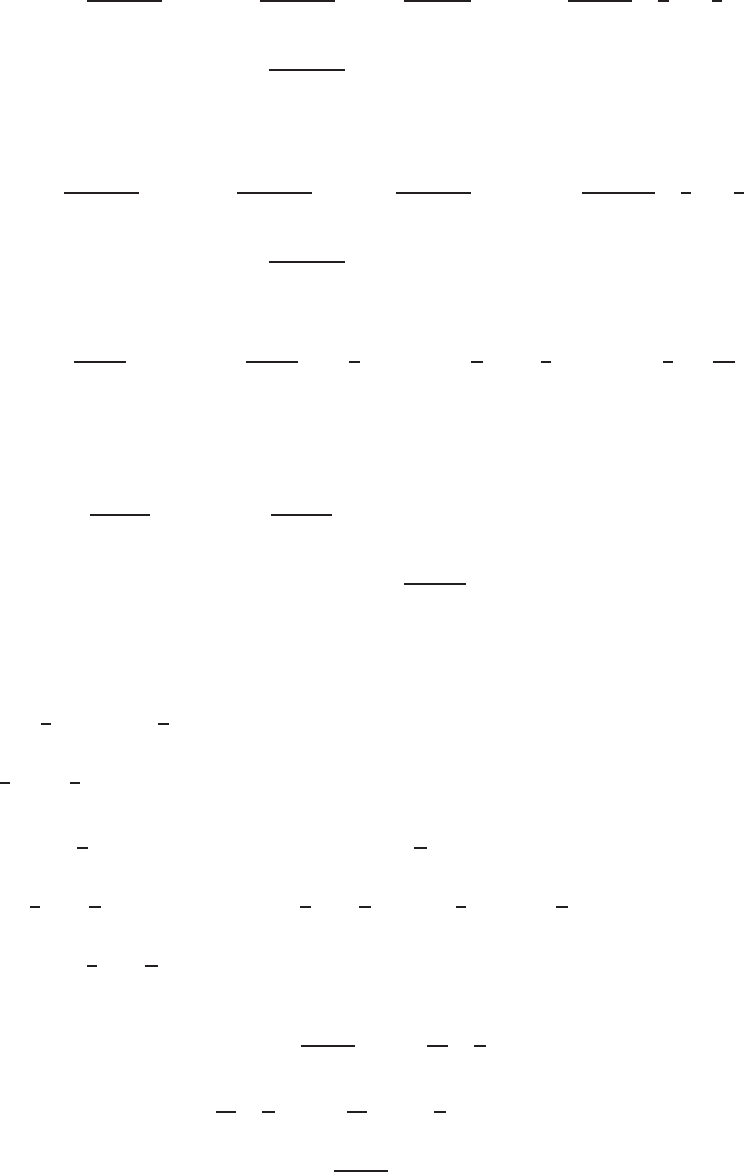
872 Chapter Nine /SOLUTIONS
19. We use the integral test and calculate the corresponding improper integral, R∞
13/(2x−1)2dx:
Z∞
1
3dx
(2x−1)2= lim
b→∞ Zb
1
3dx
(2x−1)2= lim
b→∞ −3/2
(2x−1)
b
1
=lim
b→∞ −3/2
(2b−1) +3
2=3
2.
Since the integral converges, the series ∞
X
n=1
3
(2n−1)2converges.
20. We use the integral test and calculate the corresponding improper integral, R∞
14/(2x+ 1)3dx. Using the substitution
w= 2x+ 1, we have
Z∞
1
4dx
(2x+ 1)3= lim
b→∞ Zb
1
4dx
(2x+ 1)3= lim
b→∞ −1
(2x+ 1)2
b
1
= lim
b→∞ −1
(2b+ 1)2+1
9=1
9.
Since the integral converges, the series ∞
X
n=1
4
(2n+ 1)3converges.
21. Using the integral test, we compare the series with
Z∞
0
3
x2+ 4 dx = lim
b→∞ Zb
0
3
x2+ 4 dx =3
2lim
b→∞ arctan x
2
b
0
=3
2lim
b→∞ arctan b
2=3π
4,
by integral table V-24. Since the integral converges so does the series.
22. Since the terms in the series are positive and decreasing, we can use the integral test. We calculate the corresponding
improper integral using the substitution w= 2x:
Z∞
0
2
1 + 4x2dx = lim
b→∞ Zb
0
2
1 + 4x2dx = lim
b→∞ arctan(2x)
b
0
= lim
b→∞ arctan(2b) = π/2.
Since the limit exists, the integral converges, so the series
∞
X
n=0
2
1 + 4n2converges.
23. Writing an=n/(n+ 1), we have limn→∞ an= 1 so the series diverges by Property 3 of Theorem 9.2.
24. Writing an= (n+ 1)/(2n+ 3), we have limn→∞ an= 1/2, so the limit of individual terms is not 0. The series diverges
by Property 3 of Theorem 9.2.
25. Both
∞
X
n=11
2n
and
∞
X
n=1 2
3n
are convergent geometric series. Therefore, by Property 1 of Theorem 9.2, the series
∞
X
n=1 1
2n
+2
3n
converges.
26. The series
∞
X
n=13
4n
is a convergent geometric series, but
∞
X
n=1
1
nis the divergent harmonic series.
If
∞
X
n=1 3
4n
+1
nconverged, then
∞
X
n=1 3
4n
+1
n−∞
X
n=1 3
4n
=∞
X
n=1
1
nwould converge by Theorem 9.2.
Therefore ∞
X
n=13
4n
+1
ndiverges.
27. The series can be written as ∞
X
n=1
n+ 2n
n2n=∞
X
n=1 1
2n+1
n.
If this series converges, then ∞
X
n=11
2n+1
n−∞
X
n=1
1
2n=∞
X
n=1
1
nwould converge by Theorem 9.2. Since this is the
harmonic series, which diverges, then the series
∞
X
n=1
n+ 2n
ndiverges.
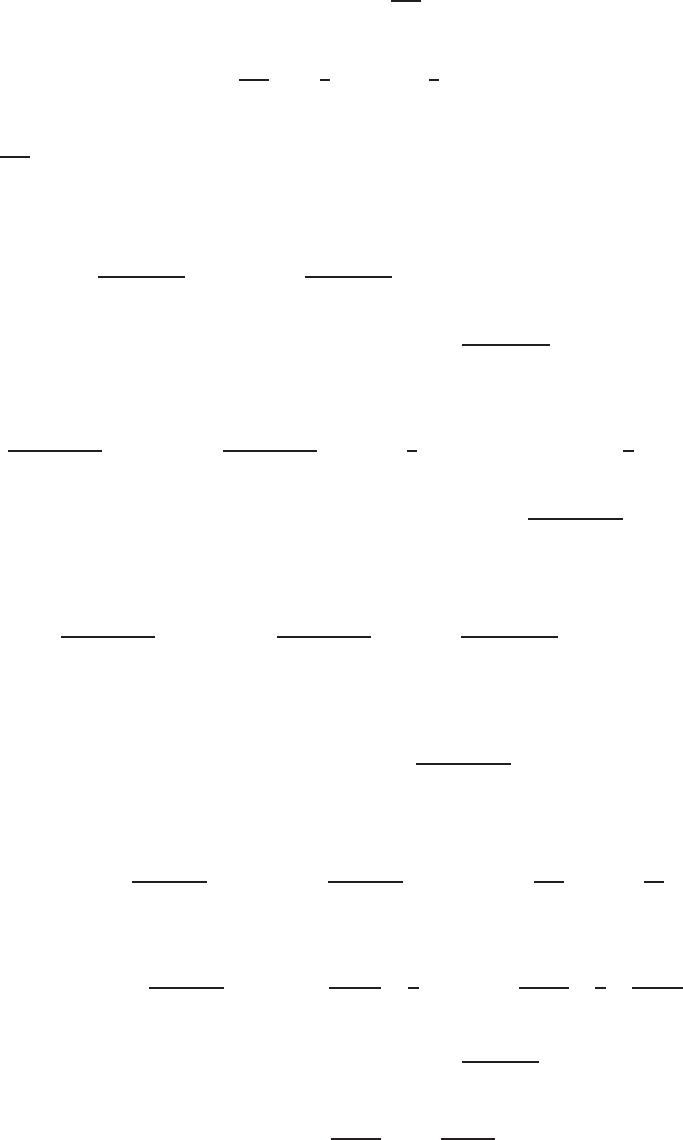
9.3 SOLUTIONS 873
28. Let an= (ln n)/n and f(x) = (ln x)/x. We use the integral test and consider the improper integral
Z∞
c
ln x
xdx.
Since ZR
c
ln x
xdx =1
2(ln x)2
R
c
=1
2(ln R)2−(ln c)2,
and ln Rgrows without bound as R→ ∞, the integral diverges. Therefore, the integral test tells us that the series,
∞
X
n=1
ln n
n, also diverges.
29. Since the terms in the series are positive and decreasing, we can use the integral test. We calculate the corresponding
improper integral using the substitution w= 1 + ln x:
Z∞
1
1
x(1 + ln x)dx = lim
b→∞ Zb
1
1
x(1 + ln x)dx = lim
b→∞ ln(1 + ln x)
b
1
=lim
b→∞ ln(1 + ln b).
Since the limit does not exist, the integral diverges, so the series
∞
X
n=1
1
n(1 + ln n)diverges.
30. We use the integral test and calculate the corresponding improper integral, R∞
3(x+ 1)/(x2+ 2x+ 2) dx:
Z∞
3
x+1
x2+ 2x+ 2 dx = lim
b→∞ Zb
3
x+ 1
x2+ 2x+ 2 dx = lim
b→∞
1
2ln |x2+ 2x+ 2|
b
3
= lim
b→∞
1
2(ln(b2+ 2b+ 2) −ln 17).
Since the limit does not exist (it is ∞), the integral diverges, so the series ∞
X
n=3
n+ 1
n2+ 2n+ 2 diverges.
31. Since the terms in the series are positive and decreasing, we can use the integral test. We calculate the corresponding
improper integral using the substitution w= 1 + x:
Z∞
0
1
x2+ 2x+ 2 dx = lim
b→∞ Zb
0
1
x2+ 2x+ 2 dx = lim
b→∞
1
1 + (x+ 1)2dx
= lim
b→∞ arctan(x+ 1)
b
0
= lim
b→∞(arctan(b+ 1) −arctan 1) = π/2−arctan 1.
Since the limit exists, the integral converges, so the series
∞
X
n=0
1
n2+ 2n+ 2 converges.
32. Since the terms in the series are positive and decreasing, we can use the integral test. We calculate the corresponding
improper integral:
Z∞
2
xlnx+ 4
x2dx = lim
b→∞ Zb
2
xln x+ 4
x2dx = lim
b→∞ Zb
2
ln x
xdx +Zb
2
4
x2dx.
Using the substitution w= ln xon the first integral, we have
lim
b→∞ Zb
2
xlnx+ 4
x2dx = lim
b→∞ (ln x)2
2−4
x
b
2
= lim
b→∞
(ln b)2
2−4
b−(ln 2)2
2+ 2.
Since the limit does not exist, the integral diverges, so the series
∞
X
n=2
nln n+ 4
n2diverges.
33. Using ln(2n) = nln 2, we see that
X1
ln(2n)=X1
(ln 2)n.
The series on the right is the harmonic series multiplied by 1/ln 2. Since the harmonic series diverges, P∞
n=1 1/ln(2n)
diverges.
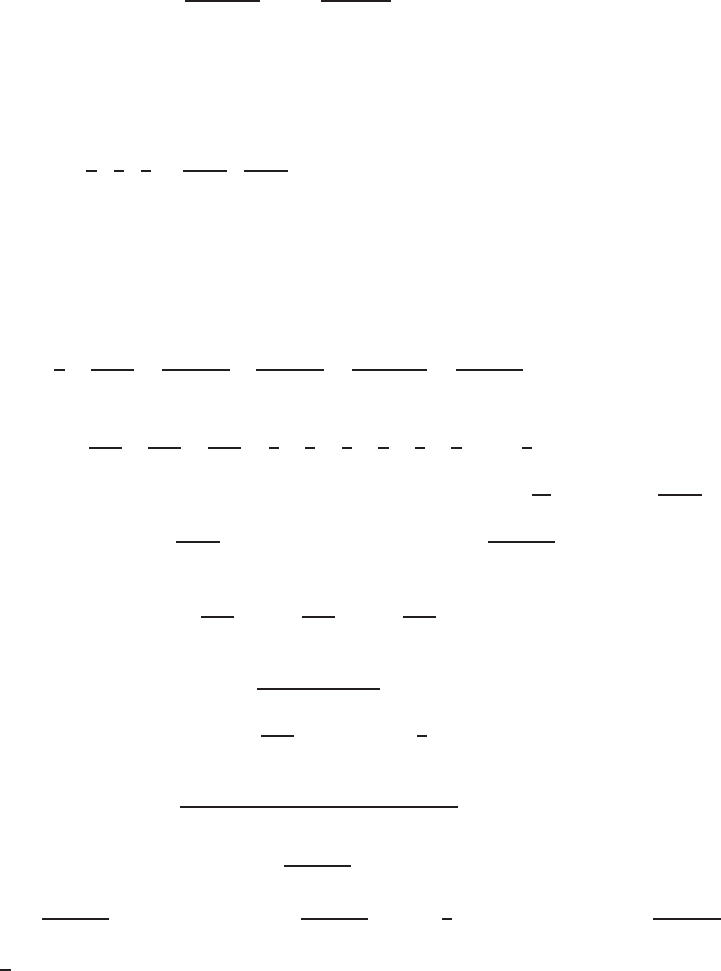
874 Chapter Nine /SOLUTIONS
34. Using ln(2n) = nln 2, we see that
∞
X
n=1
1
(ln (2n))2=∞
X
n=1
1
(ln 2)2n2.
Since P1/n2converges, P1/((ln (2))2n2)converges by property 1 of Theorem 9.2.
35. (a) With an= ln((n+ 1)/n)we have
Sn=a1+a2+a3+·· · +an−1+an
= ln(2/1) + ln(3/2) + ln(4/3) + ···+ ln(n/(n−1)) + ln((n+ 1)/n)
= ln 2
1·3
2·4
3··· n
n−1·n+ 1
n= ln(n+ 1).
(b) Since the limit of the partial sums, limn→∞ Sn= limn→∞ ln(n+ 1), does not exist, the series diverges.
36. (a) Using r=eln rand n=eln nwe have rln n=e(ln r)(ln n)=nln r.
(b) By part (a) we have rln n=nln r= 1/n−ln r. Since the p-series P1/npconverges if and only if p > 1, the series
P∞
n=1 1/n−ln rconverges if and only if −ln r > 1, which is equivalent to ln r < −1or r < 1/e. Thus P∞
n=1 rln n
converges if 0< r < 1/e and diverges if r≥1/e.
37. (a) A common denominator is k(k+ 1) so
1
k−1
k+ 1 =k+ 1
k(k+ 1) −k
k(k+ 1) =k+ 1 −k
k(k+ 1) =1
k(k+ 1) .
(b) Using the result of part (a), the partial sum can be written as
S3=1
1·2+1
2·3+1
3·4=1
1−1
2+1
2−1
3+1
3−1
4= 1 −1
4.
All of the intermediate terms cancel out, leaving only the first and last terms. Thus S10 = 1−1
11 and Sn= 1−1
n+ 1 .
(c) The limit of Snas n→ ∞ is lim
n→∞ 1−1
n+ 1 = 1 −0 = 1.Thus the series
∞
X
k=1
1
k(k+ 1) converges to 1.
38. (a) The partial sum
S3= ln 1·3
2·2+ ln 2·4
3·3+ ln 3·5
4·4.
Using the property ln(A) + ln(B) = ln(AB), we get
S3= ln 1·3·2·4·3·5
2·2·3·3·4·4.
The intermediate factors cancel out, leaving only ln 1·5
2·4,so S3= ln 5
8.
(b) For the partial sum Sn, similar steps yield
Sn= ln 1·3·2·4·3·5···n(n+ 2)
2·2·3·3·4·4···(n+ 1) ·(n+ 1) .
As before, most of the factors cancel, leaving Sn= ln n+2
2(n+ 1) .
(c) The limit of Sn= ln n+ 2
2(n+ 1) as n→ ∞is lim
n→∞ ln n+ 2
2(n+ 1) = ln 1
2.Thus the series
∞
X
k=1
ln k(k+ 2)
(k+ 1)2
converges to ln1
2.
39. Let Snbe the nth partial sum for Panand let Tnbe the nth partial sum for Pbn. Then the nth partial sums for
P(an+bn),P(an−bn), and Pkanare Sn+Tn,Sn−Tn, and kSn, respectively. To show that these series converge,
we have to show that the limits of their partial sums exist. By the properties of limits,
lim
n→∞(Sn+Tn) = lim
n→∞ Sn+ lim
n→∞ Tn
lim
n→∞(Sn−Tn) = lim
n→∞ Sn−lim
n→∞ Tn
lim
n→∞ kSn=klim
n→∞ Sn.
This proves that the limits of the partial sums exist, so the series converge.

9.3 SOLUTIONS 875
40. Let Snbe the n-th partial sum for Panand let Tnbe the n-th partial sum for Pbn. Suppose that SN=TN+k. Since
an=bnfor n≥N, we have Sn=Tn+kfor n≥N. Hence if Snconverges to a limit, so does Tn, and vice versa.
Thus, Panand Pbneither both converge or both diverge.
41. We have an=Sn−Sn−1. If Panconverges, then S= limn→∞ Snexists. Hence limn→∞ Sn−1exists and is equal
to Salso. Thus
lim
n→∞ an= lim
n→∞(Sn−Sn−1) = lim
n→∞ Sn−lim
n→∞ Sn−1=S−S= 0.
42. From Property 1 in Theorem 9.2, we know that if Panconverges, then so does Pkan.
Now suppose that Pandiverges and Pkanconverges for k6= 0. Thus using Property 1 and replacing Panby
Pkan, we know that the following series converges:
X1
k(kan) = Xan.
Thus, we have arrived at a contradiction, which means our original assumption, that ∞
X
n=1
kanconverged, must be wrong.
43. A typical partial sum of the series
∞
X
n=1
(an+1 −an), say S5, shows what happens in the general case:
S5= (a2−a1) + (a3−a2) + (a4−a3) + (a5−a4) + (a6−a5) = a6−a1
as all of the intermediate terms cancel out. The same thing will happen in the general partial sum: Sn=an+1 −a1.
Now the series ∞
X
n=1
(an+1 −an)converges if the sequence of partial sums Snhas a limit as n→ ∞.Since we’re as-
suming that the original series
∞
X
n=1
anconverges, we know that lim
n→∞ an= lim
n→∞ an+1 = 0 by property 3 of Theorem 9.2.
Thus
lim
n→∞ Sn= lim
n→∞(an+1 −a1) = 0 −a1=−a1.
Since the sequence of partial sums converges (to −a1), the series
∞
X
n=1
(an+1 −an)converges (also to −a1).
44. If an= 1 for all n, then Pandiverges but P(an+1 −an) = P0converges. If an=nfor all n, then Pandiverges,
and Pan+1 −an=P1diverges
45. (a) Suppose Z∞
c
f(x)dx diverges. In Figure 9.4 we see that for each positive integer k
ZN+k+1
N
f(x)dx ≤f(N) + f(N+ 1) + ···+f(N+k).
Since f(n) = anfor all n, we have
ZN+k+1
N
f(x)dx ≤aN+aN+1 +···+aN+k.
Since f(x)is defined for all x≥c, if R∞
cf(x)dxis divergent, then R∞
Nf(x)dx is divergent. So as k→ ∞, the
integral RN+k+1
Nf(x)dx diverges, so the partial sums of the series
∞
X
i=N
aidiverge. Thus, the series
∞
X
i=1
aidiverges.
More precisely, suppose the series converged. Then the partial sums would be bounded. (The partial sums would
be less than the sum of the series, since all the terms in the series are positive.) But that would imply that the integral
converged, by Theorem 9.1 on Convergence of Monotone Bounded Sequences. This contradicts the assumption that
R∞
Nf(x)dxis divergent.
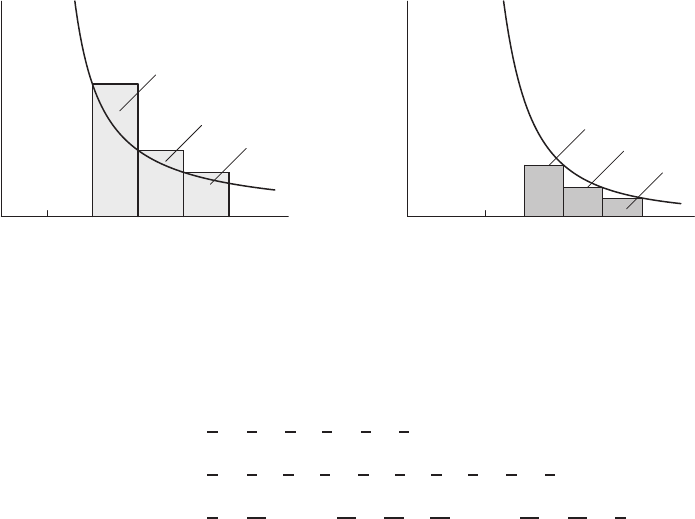
876 Chapter Nine /SOLUTIONS
(b) Suppose Z∞
c
f(x)dx converges. Let Nan integer with N≥c. Consider the series
∞
X
i=N+1
ai. The partial sums of
this series are increasing because all the terms in the series are positive. We show the partial sums are bounded using
the right-hand sum in Figure 9.5. We see that for each positive integer k
f(N+ 1) + f(N+ 2) + ···+f(N+k)≤ZN+k
N
f(x)dx.
Since f(n) = anfor all n, and c≤N, we have
aN+1 +aN+2 +··· +aN+k≤ZN+k
c
f(x)dx.
Since f(x)is a positive function, RN+k
cf(x)dx ≤Rb
cf(x)dx for all b≥N+k. Since fis positive and
R∞
cf(x)dx is convergent, RN+k
cf(x)dx < R∞
cf(x)dx, so we have
aN+1 +aN+2 +···+aN+k≤Z∞
c
f(x)dxfor all k.
Thus, the partial sums of the series
∞
X
i=N+1
aiare bounded and increasing, so this series converges by Theorem 9.1.
Now use Theorem 9.2, property 2, to conclude that ∞
X
i=1
aiconverges.
cN N + 1
✠
Area
=f(N)
✠
Area
=f(N+ 1)
✠
Area
=f(N+ 2)
f(x)
x
Figure 9.4
cN N + 1
f(x)
✠
Area
=f(N+ 3)
✠
Area
=f(N+ 1)
✠
Area
=f(N+ 2)
x
Figure 9.5
46. (a) Show that the sum of each group of fractions is more than 1/2.
(b) Explain why this shows that the harmonic series does not converge.
(a) Notice that
1
3+1
4>1
4+1
4=2
4=1
2
1
5+1
6+1
7+1
8>1
8+1
8+1
8+1
8=4
8=1
2
1
9+1
10 +···+1
16 >1
16 +1
16 +··· +1
16 =8
16 =1
2.
In the same way, we can see that the sum of the fractions in each grouping is greater than 1/2.
(b) Since the sum of the first ngroups is greater than n/2, it follows that the partial sums of the harmonic series are not
bounded. Thus, the harmonic series diverges.
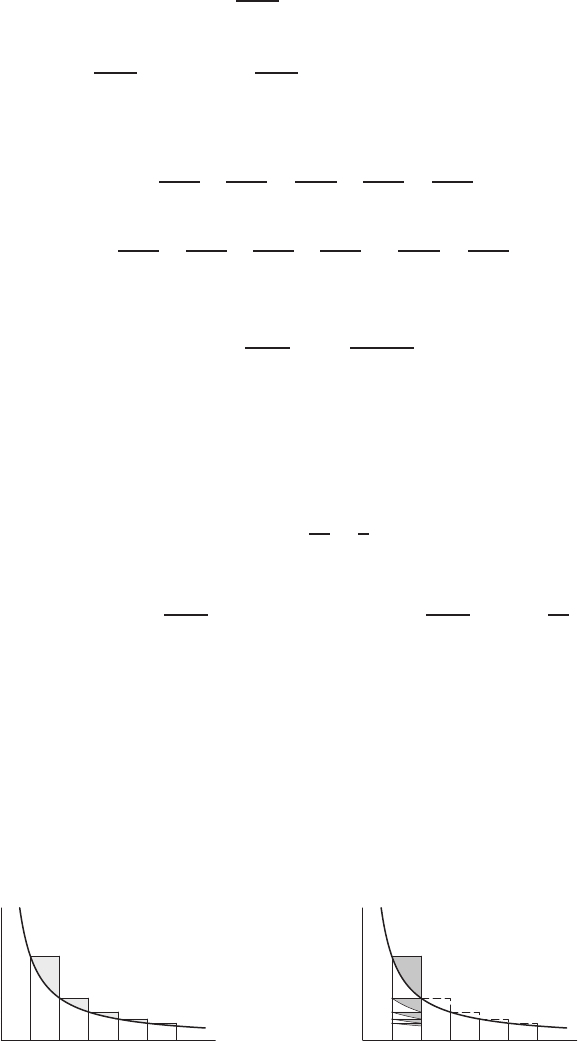
9.3 SOLUTIONS 877
47. (a) Since for x > 0,Z1
xln xdx = ln(ln x) + C
we have Z∞
2
1
xln xdx = lim
b→∞ Zb
2
1
xln xdx = lim
b→∞(ln(ln b)−ln(ln 2)) = ∞.
The series diverges by the integral test.
(b) The terms in each group are decreasing so we can bound each group as follows:
1
3 ln 3 +1
4 ln 4 >1
4 ln 4 +1
4 ln 4 =1
2 ln 4
and 1
5 ln 5 +1
6 ln 6 +1
7 ln 7 +1
8 ln 8 >41
8 ln 8 =1
2 ln 8 .
Similarly, the group whose final term is 1/(2nln(2n)) is greater than 1/(2 ln(2n)) = 1/(2(ln 2)n). Thus
2N
X
n=2
1
nln n>
N
X
n=1
1
2(ln 2)n.
The series on the right is the harmonic series multiplied by the constant 1/(2 ln 2). Since the harmonic series diverges,
P1/(nln n)diverges.
48. (a) See Figure 9.6. We draw the left-hand sum approximation to Rn+1
1(1/x)dx using ∆x= 1. Since the rectangles lie
everywhere above the curve, for every positive integer k, we conclude that
Zk+1
k
dx
x<1
k.
We see that
an+1 −an=1
n+ 1 −ln(n+ 2) + ln(n+ 1) = 1
n+ 1 −Zn+2
n+1
dx
x,
so we see that an< an+1 for every positive integer n.
(b) For every positive integer n, the value of anrepresents the difference between the left-hand approximation of
Rn+1
1(1/x)dx and the integral itself.
This difference can be viewed as a sum of areas of nroughly triangular pieces, with the kth piece having a
vertical side running from y= 1/k to y= 1/(k+ 1). Each piece has width 1. All the pieces can be moved to the
left and stacked up to fit inside the first rectangle of the left-hand approximation, which runs from x= 1 to x= 2
and from y= 0 to y= 1. Thus the sum of all these stacked areas is less than 1, so an<1for all n. See Figure 9.7.
(c) Since anis an increasing sequence bounded above by 1, Theorem 9.1 ensures that limn→∞ anexists.
(d) The sequence converges slowly, but a calculator or computer gives a200 = 0.5747. For comparison, a100 = 0.5723,
a500 = 0.5762. Thus, γ≈0.58. More extensive calculations show that γ≈0.577216.
1 2 ... n n + 1
1
f(x) = 1/x
x
Figure 9.6
1 2 · ·· n n + 1
1
f(x) = 1/x
x
Figure 9.7
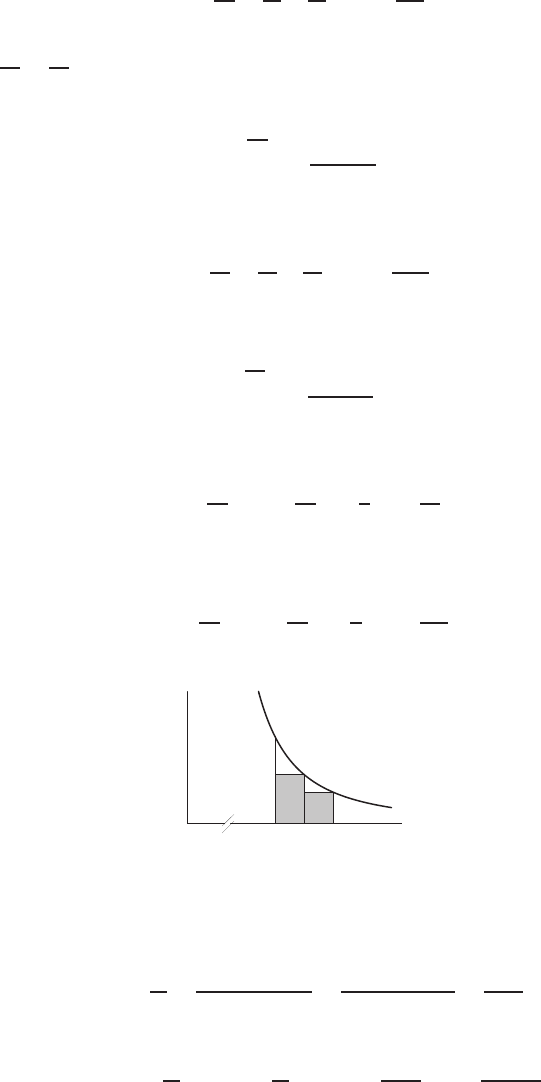
878 Chapter Nine /SOLUTIONS
49. (a) A calculator or computer gives
20
X
1
1
n2=1
12+1
22+···+1
202= 1.596.
(b) Since
∞
X
1
1
n2=π2
6, the answer to part (a) gives
π2
6≈1.596
π≈√6·1.596 = 3.09
(c) A calculator or computer gives
100
X
1
1
n2=1
12+1
22+··· +1
1002= 1.635,
so
π2
6≈1.635
π≈√6·1.635 = 3.13.
(d) The error in approximating π2/6by P20
11/n2is the tail of the series P∞
21 1/n2. From Figure 9.8, we see that
∞
X
21
1
n2<Z∞
20
dx
x2=−1
x
∞
20
=1
20 = 0.05.
A similar argument leads to a bound for the error in approximating π2/6by P100
11/n2as
∞
X
101
1
n2<Z∞
100
dx
x2=−1
x
∞
100
=1
100 = 0.01.
20 21 22 . . .
1/x2
x
Figure 9.8
50. (a) We have e > 1 + 1 + 1/2 + 1/6 + 1/24 = 65/24 = 2.708.
(b) We have 1
n!=1
1·2·3·4···n≤1
1·2·2·2···2=1
2n−1.
(c) The inequality in part (b) can be used to replace the given series with a geometric series that we can sum.
e=∞
X
n=0
1
n!= 1 + ∞
X
n=1
1
n!<1 + ∞
X
n=1
1
2n−1= 1 + 1
1−1/2= 3.
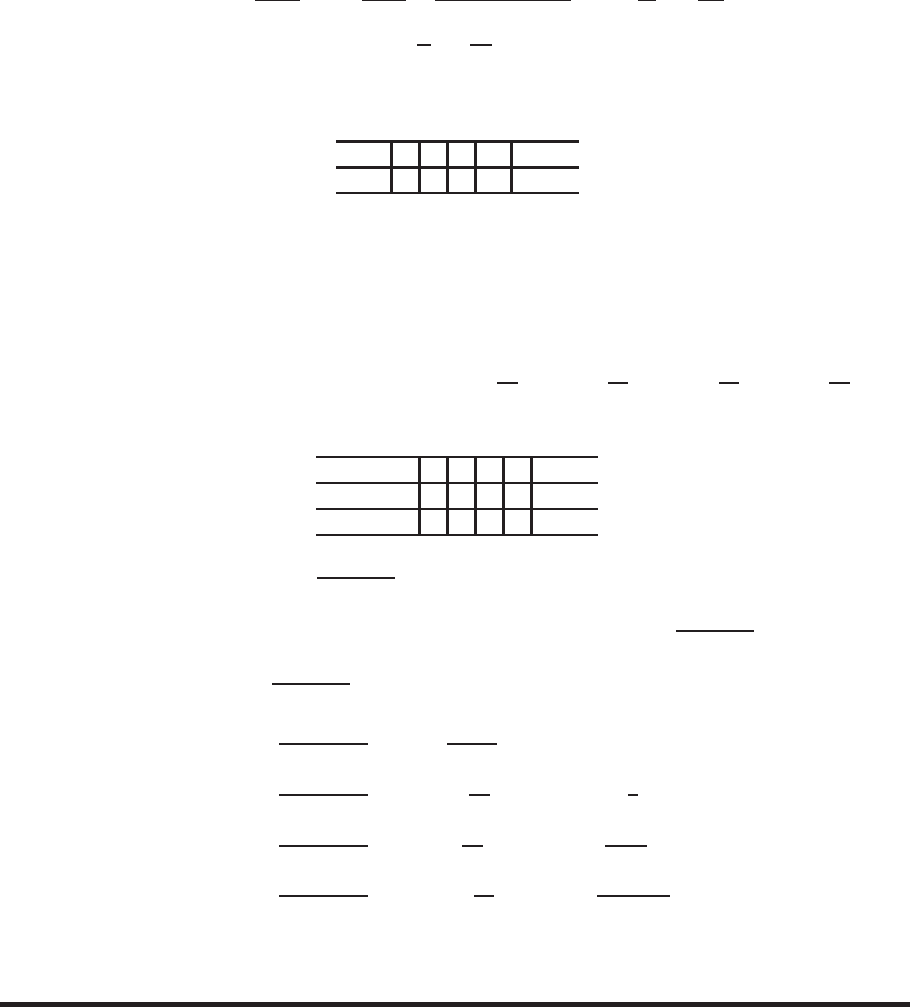
9.3 SOLUTIONS 879
51. (a) The right-hand sum for RN
0xNdx with ∆x= 1 is the sum 15·1 + 25·1 + 35·1 + ···+N5·1 = SN. This sum is
greater than the integral because the integrand x5is increasing on the interval 0< x < N. Since RN
0x5dx =N6/6,
we have SN> N6/6.
(b) The left-hand sum for RN+1
1xNdx with ∆x= 1 is the sum 15·1 + 25·1 + 35·1 + ···+N5·1 = SN.
This sum is less than the integral because the integrand x5is increasing on the interval 1< x < N + 1. Since
RN+1
1x5dx = ((N+ 1)6−1)/6, we have SN<((N+ 1)6−1)/6.
(c) By parts (a) and (b) we have
N6/6
N6/6= 1 <SN
N6/6<((N+ 1)6−1)/6
N6/6= (1 + 1
N)6−1
N6.
Since both limN→∞ 1 = 1 and limN→∞((1 + 1
N)6−1
N6) = 1, we conclude that the limit in the middle also equals
1, limN→∞ SN/(N6/6) = 1.
52. (a) Neglecting signs, the table reveals a regular pattern reminiscent of a linear function with slope 4. We see that term n
is given by 4n−3:
Term 1 2 3 4 n
Value 1 5 9 13 4n−3
The odd-numbered terms are positive and the even-numbered terms are negative, so
cn=(4n−3for nodd
−1·(4n−3) for neven.
Notice that −(−1)nis negative if nis even, and positive if nis odd. Thus we can write cn=−(−1)n(4n−3).
Since −(−1)n= (−1)1(−1)n= (−1)n+1,we can also write this cn= (−1)n+1(4n−3).
(b) Using double factorial (!!) notation, we can write: b2=1!!
2!! 3
, b3=3!!
4!! 3
, b4=5!!
6!! 3
, b5=7!!
8!! 3
, . . ..
Focusing on the patterns in the table of 1,3,5,7in the numerator and 2,4,6,8in the denominator, we see that both
are reminiscent of linear functions with slope 2:
Term 2 3 4 5 n
Numerator 1 3 5 7 2n−3
Denominator 2 4 6 8 2n−2
This means we can write bn=(2n−3)!!
(2n−2)!! 3
.
(c) Putting together our answers for parts (a) and (b), we have an=−(−1)n(4n−3) (2n−3)!!
(2n−2)!! 3
,or (equivalently)
an= (−1)n+1(4n−3) (2n−3)!!
(2n−2)!! 3
.Checking our answer, we have:
a1=−(−1)1(4 ·1−3) (2 ·1−3)!!
(2 ·1−2)!! 3
= 1 (−1)!!
0!! 3
= 1 since (−1)!! = 0!! = 1
a2=−(−1)2(4 ·2−3) (2 ·2−3)!!
(2 ·2−2)!! 3
=−51!!
2!! 2
=−51
23
since 1!! = 1 and 2!! = 2
a3=−(−1)3(4 ·3−3) (2 ·3−3)!!
(2 ·3−2)!! 3
= 9 3!!
4!! 2
= 9 1×3
2×43
s4=−(−1)4(4 ·4−3) (2 ·4−3)!!
(2 ·4−2)!! 3
=−13 5!!
6!! 2
=−13 1×3×5
2×4×63
,
and so on, as required.
Strengthen Your Understanding
53. If the terms of a series do not approach zero, the series does not converge. But just because the terms approach zero does
not mean the series converges. For example, P(1/n)diverges even though the terms approach zero.

880 Chapter Nine /SOLUTIONS
54. The integral R∞
11/x3dx converges to 1
2, because
Z∞
1
dx
x3= lim
b→∞ Zb
1
dx
x3= lim
b→∞ −1
2b2+1
2=1
2.
However, the series P∞
n=1 1/n3= 1 + 1/23+ 1/33+···has a sum which is larger than 1 as its first term is 1 and all
the subsequent terms are positive. Thus, the sum of the series is not 1
2.
In general, the sum of a series and the value of an improper integral used to test it for convergence are not the same.
Both converge or both diverge, but if they converge, usually they converge to different values.
55. The series P∞
n=11/n is an example. The terms of the series converge to zero, but the series is a p-series with p≤1, and
therefore the series diverges.
56. One example is the series
∞
X
n=1
1
n2. This series is convergent because it is a p-series with p= 2 >1.
If an= 1/n2, then √an= 1/n, and the series P∞
n=1 1/n diverges because it is a p-series with p= 1.
57. True. Writing out the terms of this series, we have
(1 + (−1)1) + (1 + (−1)2) + (1 + (−1)3) + (1 + (−1)4) + ···
= (1 −1) + (1 + 1) + (1 −1) + (1 + 1) + ···
= 0 + 2 + 0 + 2 + ···.
58. True. The definition of convergence of a series is that its partial sums are a convergent sequence.
59. False. For example, if an= 1/n and bn=−1/n, then |an+bn|= 0, so P|an+bn|converges. However P|an|and
P|bn|are the harmonic series, which diverge.
60. False. The terms in the series do not go to zero:
2(−1)1+ 2(−1)2+ 2(−1)3+ 2(−1)4+ 2(−1)5+··· = 2−1+ 21+ 2−1+ 21+ 2−1+···
= 1/2 + 2 + 1/2 + 2 + 1/2 + ···.
61. True. If the terms do not tend to zero, the partial sums do not tend to a limit. For example, if the terms are all greater than
0.1, the partial sums will grow without bound.
62. False. Consider the series
∞
X
n=1
1/n. This series does not converge, but 1/n →0as n→ ∞.
63. False. If an=bn= 1/n, then Xanand Xbndo not converge. However, anbn= 1/n2, so Xanbndoes converge.
64. False. If anbn= 1/n2and an=bn= 1/n, then Xanbnconverges, but Xanand Xbndo not converge.
65. (d)
Solutions for Section 9.4
Exercises
1. Let an= 1/(n−3), for n≥4. Since n−3< n, we have 1/(n−3) >1/n, so
an>1
n.
The harmonic series
∞
X
n=4
1
ndiverges, so the comparison test tells us that the series
∞
X
n=4
1
n−3also diverges.
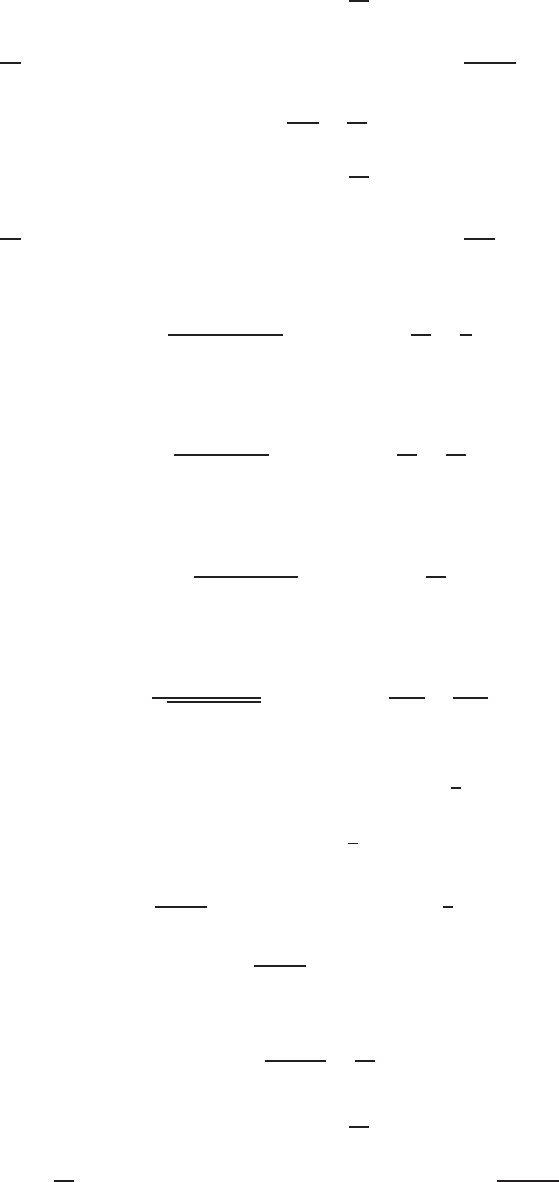
9.4 SOLUTIONS 881
2. Let an= 1/(n2+ 2). Since n2+ 2 > n2, we have 1/(n2+ 2) <1/n2, so
0< an<1
n2.
The series
∞
X
n=1
1
n2converges, so the comparison test tells us that the series
∞
X
n=1
1
n2+ 2 also converges.
3. Let an=e−n/n2. Since e−n<1, for n≥1,we have e−n
n2<1
n2, so
0< an<1
n2.
The series ∞
X
n=1
1
n2converges, so the comparison test tells us that the series ∞
X
n=1
e−n
n2also converges.
4. As ngets large, polynomials behave like the leading term, so for large n,
n3+ 1
n4+ 2n3+ 2nbehaves like n3
n4=1
n.
Since the series P∞
n=1 1/n diverges, we predict that the given series will diverge.
5. As ngets large, polynomials behave like the leading term, so for large n,
n+ 4
n3+ 5n−3behaves like n
n3=1
n2.
Since the series P∞
n=1 1/n2converges, we predict that the given series will converge.
6. As ngets large, polynomials behave like the leading term, so for large n,
1
n4+ 3n3+ 7 behaves like 1
n4.
Since the series P∞
n=1 1/n4converges, we predict that the given series will converge.
7. As ngets large, polynomials behave like the leading term, so for large n,
n−4
√n3+n2+ 8 behaves like n
n3/2=1
n1/2.
Since the series P∞
n=1 1/n1/2diverges, we predict that the given series will diverge.
8. Let an= 1/(3n+ 1). Since 3n+ 1 >3n, we have 1/(3n+ 1) <1/3n=1
3n
, so
0< an<1
3n
.
Thus we can compare the series
∞
X
n=1
1
3n+ 1 with the geometric series
∞
X
n=1 1
3n
.This geometric series converges since
|1/3|<1, so the comparison test tells us that ∞
X
n=1
1
3n+ 1 also converges.
9. Let an= 1/(n4+en). Since n4+en> n4, we have
1
n4+en<1
n4,
so
0< an<1
n4.
Since the p-series
∞
X
n=1
1
n4converges, the comparison test tells us that the series
∞
X
n=1
1
n4+enalso converges.

882 Chapter Nine /SOLUTIONS
10. Since ln n≤nfor n≥2, we have 1/ln n≥1/n, so the series diverges by comparison with the harmonic series,
P1/n.
11. Let an=n2/(n4+ 1). Since n4+ 1 > n4, we have 1
n4+ 1 <1
n4, so
an=n2
n4+ 1 <n2
n4=1
n2,
therefore
0< an<1
n2.
Since the p-series
∞
X
n=1
1
n2converges, the comparison test tells us that the series
∞
X
n=1
n2
n4+ 1 converges also.
12. We know that |sin n|<1, so
nsin2n
n3+ 1 ≤n
n3+ 1 <n
n3=1
n2.
Since the p-series
∞
X
n=1
1
n2converges, comparison gives that
∞
X
n=1
nsin2n
n3+ 1 converges.
13. Let an= (2n+ 1)/(n2n−1). Since n2n−1< n2n+n=n(2n+ 1), we have
2n+ 1
n2n−1>2n+ 1
n(2n+ 1) =1
n.
Therefore, we can compare the series
∞
X
n=1
2n+ 1
n2n−1with the divergent harmonic series
∞
X
n=1
1
n.The comparison test tells
us that ∞
X
n=1
2n+ 1
n2n−1also diverges.
14. Since an=n
2n, replacing nby n+ 1 gives an+1 =n+ 1
2n+1 . Thus
|an+1|
|an|=(n+ 1)/2n+1
n/2n=n+ 1
2n,
so
L= lim
n→∞ |an+1|
|an|= lim
n→∞
n+ 1
2n= lim
n→∞
1 + 1/n
2=1
2.
Since L < 1, the ratio test tells us that ∞
X
n=1
n
2nconverges.
15. Since an= 1/(2n)!, replacing nby n+ 1 gives an+1 = 1/(2n+ 2)!. Thus
|an+1|
|an|=
1
(2n+ 2)!
1
(2n)!
=(2n)!
(2n+ 2)! =(2n)!
(2n+ 2)(2n+ 1)(2n)! =1
(2n+ 2)(2n+ 1) ,
so
L= lim
n→∞ |an+1|
|an|= lim
n→∞
1
(2n+ 2)(2n+ 1) = 0.
Since L= 0, the ratio test tells us that
∞
X
n=1
1
(2n)! converges.
16. Since an= (n!)2/(2n)!, replacing nby n+ 1 gives an+1 = ((n+ 1)!)2/(2n+ 2)!. Thus,
|an+1|
|an|=
((n+ 1)!)2
(2n+ 2)!
(n!)2
(2n)!
=((n+ 1)!)2
(2n+ 2)! ·(2n)!
(n!)2.
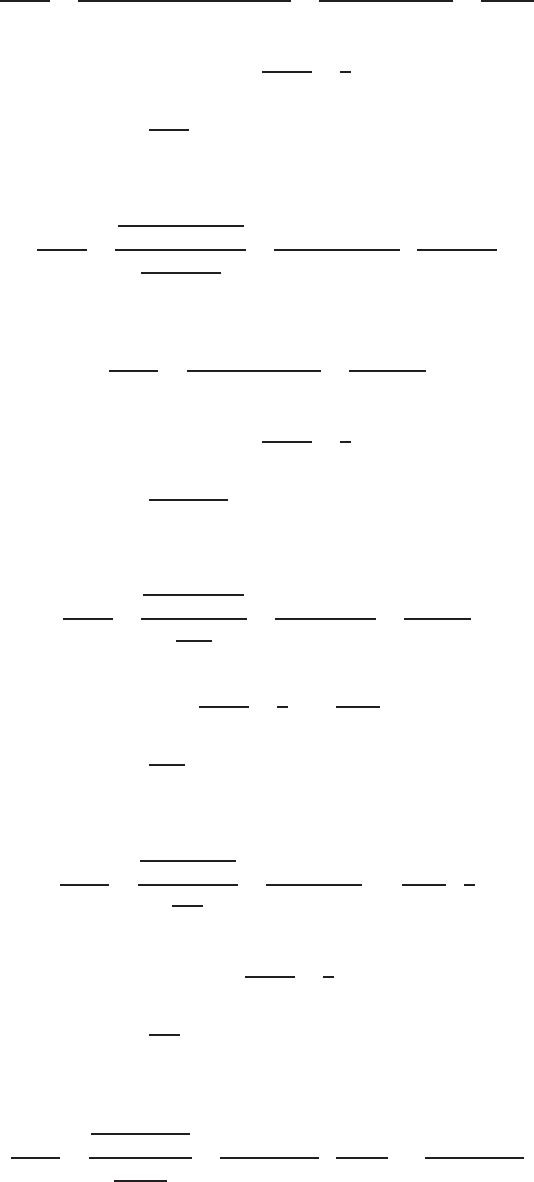
9.4 SOLUTIONS 883
However, since (n+ 1)! = (n+ 1)n!and (2n+ 2)! = (2n+ 2)(2n+ 1)(2n)!, we have
|an+1|
|an|=(n+ 1)2(n!)2(2n)!
(2n+ 2)(2n+ 1)(2n)!(n!)2=(n+ 1)2
(2n+ 2)(2n+ 1) =n+ 1
4n+ 2 ,
so
L= lim
n→∞ |an+1|
|an|=1
4.
Since L < 1, the ratio test tells us that ∞
X
n=1
(n!)2
(2n)! converges.
17. Since an=n!(n+ 1)!/(2n)!, replacing nby n+ 1 gives an+1 = (n+ 1)!(n+ 2)!/(2n+ 2)!. Thus,
|an+1|
|an|=
(n+ 1)!(n+ 2)!
(2n+ 2)!
n!(n+ 1)!
(2n)!
=(n+ 1)!(n+ 2)!
(2n+ 2)! ·(2n)!
n!(n+ 1)! .
However, since (n+ 2)! = (n+ 2)(n+ 1)n!and (2n+ 2)! = (2n+ 2)(2n+ 1)(2n)!, we have
|an+1|
|an|=(n+ 2)(n+ 1)
(2n+ 2)(2n+ 1) =n+ 2
2(2n+ 1) ,
so
L= lim
n→∞ |an+1|
|an|=1
4.
Since L < 1, the ratio test tells us that ∞
X
n=1
n!(n+ 1)!
(2n)! converges.
18. Since an= 1/(rnn!), replacing nby n+ 1 gives an+1 = 1/(rn+1(n+ 1)!). Thus
|an+1|
|an|=
1
rn+1(n+ 1)!
1
rnn!
=rnn!
rn+1(n+ 1)! =1
r(n+ 1) ,
so
L= lim
n→∞ |an+1|
|an|=1
rlim
n→∞
1
n+ 1 = 0.
Since L= 0, the ratio test tells us that ∞
X
n=1
1
rnn!converges for all r > 0.
19. Since an= 1/(nen), replacing nby n+ 1 gives an+1 = 1/(n+ 1)en+1. Thus
|an+1|
|an|=
1
(n+ 1)en+1
1
nen
=nen
(n+ 1)en+1 =n
n+ 1 1
e.
Therefore
L= lim
n→∞ |an+1|
|an|=1
e<1.
Since L < 1, the ratio test tells us that ∞
X
n=1
1
nenconverges.
20. Since an= 2n/(n3+ 1), replacing nby n+ 1 gives an+1 = 2n+1/((n+ 1)3+ 1). Thus
|an+1|
|an|=
2n+1
(n+ 1)3+ 1
2n
n3+ 1
=2n+1
(n+ 1)3+ 1 ·n3+ 1
2n= 2 n3+ 1
(n+ 1)3+ 1 ,
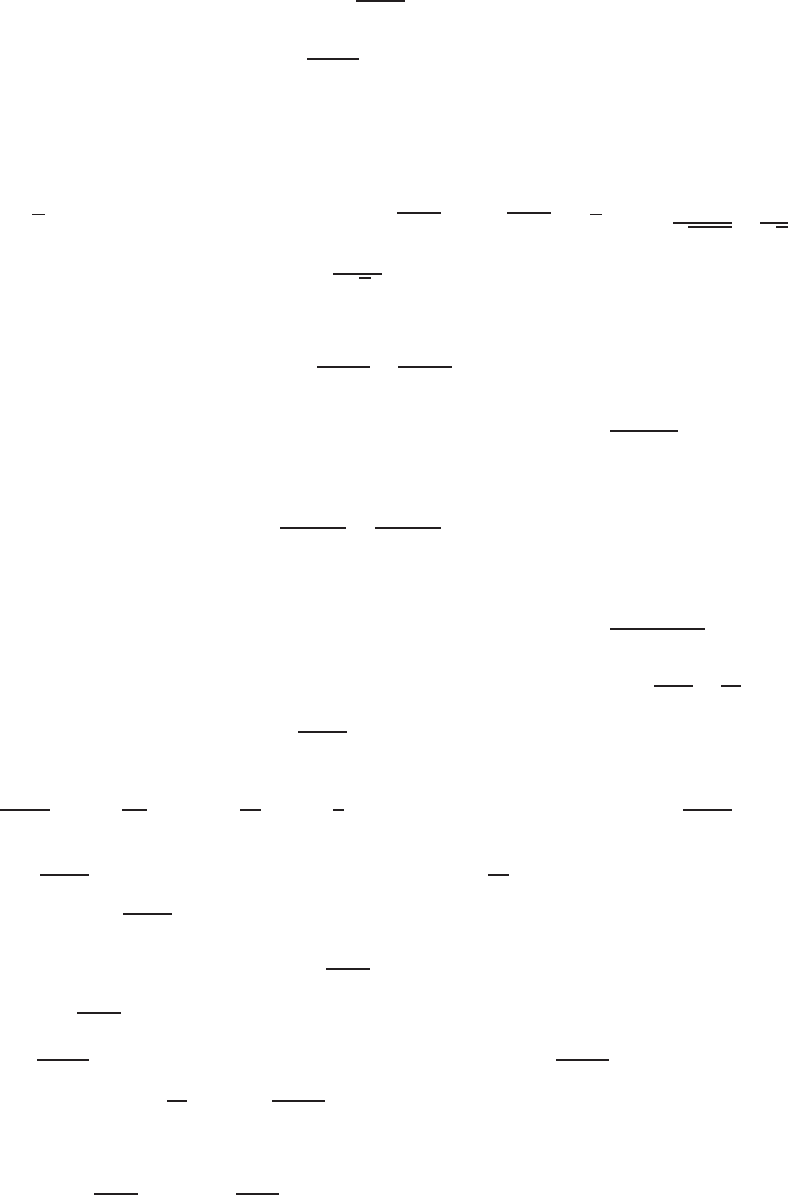
884 Chapter Nine /SOLUTIONS
so
L= lim
n→∞ |an+1|
|an|= 2.
Since L > 1the ratio test tells us that the series
∞
X
n=0
2n
n3+ 1 diverges.
21. Even though the first term is negative, the terms alternate in sign, so it is an alternating series.
22. Since cos(nπ) = (−1)n, this is an alternating series.
23. Since (−1)ncos(nπ) = (−1)2n= 1, this is not an alternating series.
24. Since an= cos nis not always positive, this is not an alternating series.
25. Let an= 1/√n. Then replacing nby n+1 we have an+1 = 1/√n+ 1. Since √n+ 1 >√n, we have 1
√n+ 1 <1
√n,
hence an+1 < an. In addition, limn→∞ an= 0 so ∞
X
n=0
(−1)n
√nconverges by the alternating series test.
26. Let an= 1/(2n+ 1). Then replacing nby n+ 1 gives an+1 = 1/(2n+ 3). Since 2n+ 3 >2n+ 1, we have
0< an+1 =1
2n+ 3 <1
2n+ 1 =an.
We also have limn→∞ an= 0. Therefore, the alternating series test tells us that the series ∞
X
n=1
(−1)n−1
2n+ 1 converges.
27. Let an= 1/(n2+ 2n+ 1) = 1/(n+ 1)2. Then replacing nby n+ 1 gives an+1 = 1/(n+ 2)2. Since n+ 2 > n + 1,
we have 1
(n+ 2)2<1
(n+ 1)2
so
0< an+1 < an.
We also have limn→∞ an= 0. Therefore, the alternating series test tells us that the series
∞
X
n=1
(−1)n−1
n2+ 2n+ 1 converges.
28. Let an= 1/en. Then replacing nby n+ 1 we have an+1 = 1/en+1. Since en+1 > en, we have 1
en+1 <1
en, hence
an+1 < an. In addition, limn→∞ an= 0 so
∞
X
n=1
(−1)n
enconverges by the alternating series test. We can also observe
that the series is geometric with ratio x=−1/e can hence converges since |x|<1.
29. Both X(−1)n
2n=X−1
2n
and X1
2n=X1
2n
are convergent geometric series. Thus X(−1)n
2nis abso-
lutely convergent.
30. The series X(−1)n
2nconverges by the alternating series test. However X1
2ndiverges because it is a multiple of the
harmonic series. Thus X(−1)n
2nis conditionally convergent.
31. Since
lim
n→∞
n
n+ 1 = 1 6= 0
the series X(−1)nn
n+ 1 does not converge. It is a divergent series.
32. The series X(−1)n
n4+ 7 converges by the alternating series test. Moreover, the series X1
n4+ 7 converges by comparison
with the convergent p-series X1
n4. Thus X(−1)n
n4+ 7 is absolutely convergent.
33. We first check absolute convergence by deciding whether P1/(nln n)converges by using the integral test. Since
Z∞
2
dx
xln x= lim
b→∞ Zb
2
dx
xln x= lim
b→∞ ln(ln(x))
b
2
= lim
b→∞(ln(ln(b)) −ln(ln(2))),

9.4 SOLUTIONS 885
and since this limit does not exist, X1
nln ndiverges.
We now check conditional convergence. The original series is alternating so we check whether an+1 < an. Consider
an=f(n), where f(x) = 1/(xln x). Since
d
dx 1
xln x=−1
x2ln x1 + 1
ln x
is negative for x > 1, we know that anis decreasing for n≥2. Thus, for n≥2
an+1 =1
(n+ 1) ln(n+ 1) <1
nln n=an.
Since 1/(nln n)→0as n→ ∞, we see that X(−1)n−1
nln nis conditionally convergent.
34. Although cos nis sometimes positive and sometimes negative, the series is not alternating because is does not change
sign every term. For example cos 1 >0, whereas cos 2 and cos 3 are negative. If we use the comparison test on
∞
X
n=1
cos n
n2,
we find
cos n
n2≤1
n2.
The series P∞
n=11/n2is a p-series with p= 2, and therefore converges. Thus the original series is absolutely convergent.
35. This is an alternating series that converges by the alternating series test. However
∞
X
n=1
(−1)n−1
√n=∞
X
n=1
1
√n,
which is a p-series with p= 1/2, so this series diverges. Thus the original series is conditionally convergent.
36. We first check absolute convergence by deciding whether Parcsin(1/n)converges. Since sin θ≈θfor small angles θ,
writing x= sin θwe see that
arcsin x≈x.
Since arcsin x”behaves like“ xfor small x, we expect arcsin(1/n)to ”behave like“ 1/n for large n. To confirm this we
calculate
lim
n→∞
arcsin(1/n)
1/n = lim
x→0
arcsin x
x= lim
θ→0
θ
sin θ= 1.
Thus Parcsin(1/n)diverges by limit comparison with the harmonic series P1/n.
We now check conditional convergence. The original series is alternating, so we check whether an+1 < an. Consider
an=f(n), where f(x) = arcsin(1/x). Since
d
dx arcsin 1
x=1
p1−(1/x)2−1
x2
is negative for x > 1, we know that anis decreasing for n > 1. Therefore, for n > 1
an+1 = arcsin(1/(n+ 1)) <arcsin(1/n) = an.
Since arcsin(1/n)→0as n→ ∞, we see that X(−1)n−1arcsin(1/n)is conditionally convergent.
37. We first check absolute convergence by deciding whether Xarctan(1/n)
n2converges. Since arctan xis the angle be-
tween −π/2and π/2, we have arctan(1/n)< π/2for all n. We compare
arctan(1/n)
n2<π/2
n2,
and conclude that since (π/2) P1/n2converges, Xarctan(1/n)
n2converges. Thus X(−1)n−1arctan(1/n)
n2is
absolutely convergent.

886 Chapter Nine /SOLUTIONS
38. We have
an
bn
=(5n+ 1)/(3n2)
1/n =5n+ 1
3n,
so
lim
n→∞
an
bn
= lim
n→∞
5n+ 1
3n=5
3=c6= 0.
Since
∞
X
n=1
1
nis a divergent harmonic series, the original series diverges.
39. We have an
bn
=((1 + n)/(3n))n
(1/3)n=n+ 1
nn
=1 + 1
nn
,
so
lim
n→∞
an
bn
= lim
n→∞ 1 + 1
nn
=e=c6= 0.
Since
∞
X
n=11
3n
is a convergent geometric series, the original series converges.
40. The nth term is an= 1 −cos(1/n)and we are taking bn= 1/n2. We have
lim
n→∞
an
bn
= lim
n→∞
1−cos(1/n)
1/n2.
This limit is of the indeterminate form 0/0so we evaluate it using l’Hopital’s rule. We have
lim
n→∞
1−cos(1/n)
1/n2= lim
n→∞
sin(1/n)(−1/n2)
−2/n3= lim
n→∞
1
2
sin(1/n)
1/n = lim
x→0
1
2
sin x
x=1
2.
The limit comparison test applies with c= 1/2. The p-series P1/n2converges because p= 2 >1. Therefore
P(1 −cos(1/n)) also converges.
41. The nth term an= 1/(n4−7) behaves like 1/n4for large n, so we take bn= 1/n4. We have
lim
n→∞
an
bn
= lim
n→∞
1/(n4−7)
1/n4= lim
n→∞
n4
n4−7= 1.
The limit comparison test applies with c= 1. The p-series P1/n4converges because p= 4 >1. Therefore
P1/(n4−7) also converges.
42. The nth term an= (n+ 1)/(n2+ 2) behaves like n/n2= 1/n for large n, so we take bn= 1/n. We have
lim
n→∞
an
bn
= lim
n→∞
(n+ 1)/(n2+ 2)
1/n = lim
n→∞
n2+n
n2+ 2 = 1.
The limit comparison test applies with c= 1. Since the harmonic series P1/ndiverges, the series P(n+ 1)/(n2+ 2)
also diverges.
43. The nth term an= (n3−2n2+n+ 1)/(n4−2) behaves like n3/n4= 1/n for large n, so we take bn= 1/n. We have
lim
n→∞
an
bn
= lim
n→∞
(n3−2n2+n+ 1)/(n4−2)
1/n = lim
n→∞
n4−2n3+n2+n
n4−2= 1.
The limit comparison test applies with c= 1. The harmonic series P1/ndiverges. Thus Pn3−2n2+n+ 1/n4−2
also diverges.
44. The nth term an= 2n/(3n−1) behaves like 2n/3nfor large n, so we take bn= 2n/3n. We have
lim
n→∞
an
bn
= lim
n→∞
2n/(3n−1)
2n/3n= lim
n→∞
3n
3n−1= lim
n→∞
1
1−3−n= 1.
The limit comparison test applies with c= 1. The geometric series P2n/3n=P(2/3)nconverges. Therefore
P2n/(3n−1) also converges.
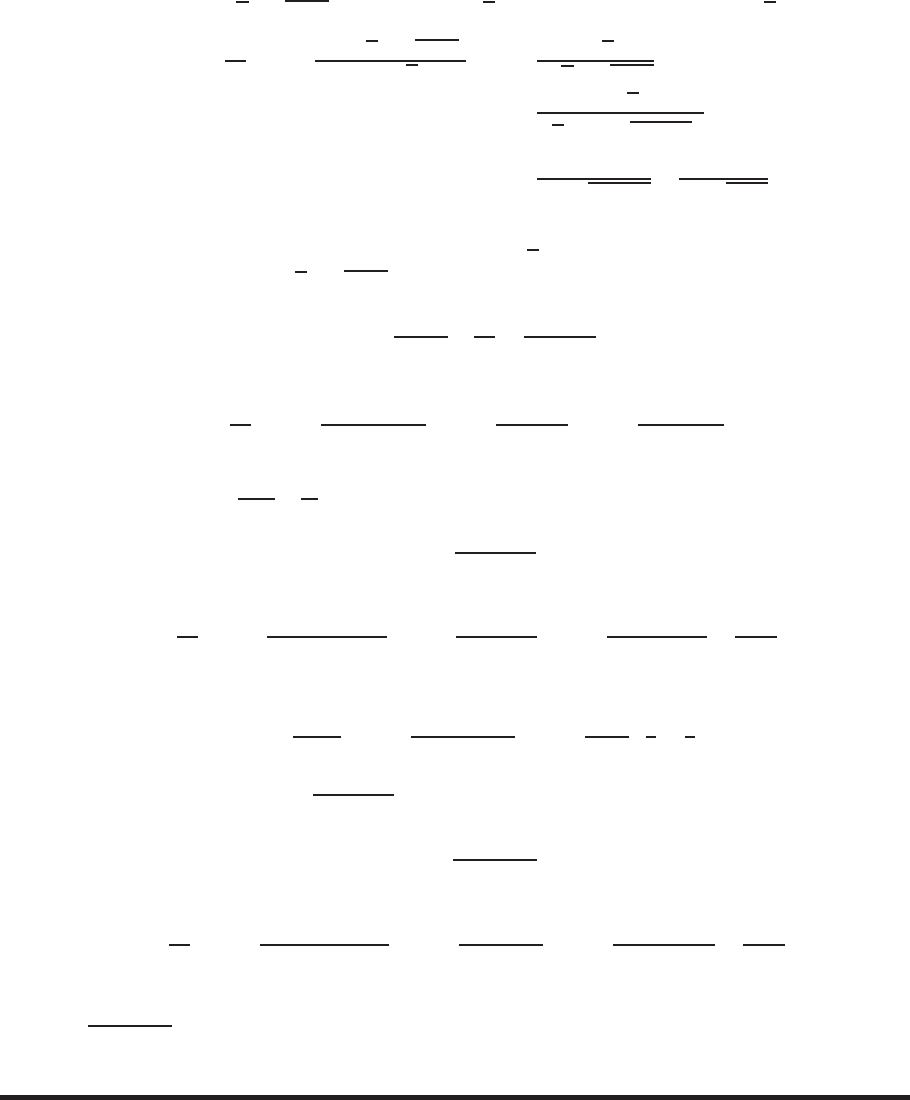
9.4 SOLUTIONS 887
45. The nth term an= 1/(2√n+√n+ 2) behaves like 1/(3√n)for large n, so we take bn= 1/(3√n). We have
lim
n→∞
an
bn
= lim
n→∞
1/(2√n+√n+ 2)
1/(3√n)= lim
n→∞
3√n
2√n+√n+ 2
= lim
n→∞
3√n
√n2 + p1 + 2/n
= lim
n→∞
3
2 + p1 + 2/n =3
2 + √1 + 0
= 1.
The limit comparison test applies with c= 1. The series P1/(3√n)diverges because it is a multiple of a p-series with
p= 1/2<1. Therefore P1/(2√n+√n+ 2) also diverges.
46. The nth term,
an=1
2n−1−1
2n=1
4n2−2n,
behaves like 1/(4n2)for large n, so we take bn= 1/(4n2). We have
lim
n→∞
an
bn
= lim
n→∞
1/(4n2−2n)
1/(4n2)= lim
n→∞
4n2
4n2−2n= lim
n→∞
1
1−1/(2n)= 1.
The limit comparison test applies with c= 1. The series P1/(4n2)converges because it is a multiple of a p-series with
p= 2 >1. Therefore P1
2n−1−1
2nalso converges.
47. The nth term,
an=n
cos n+en,
behaves like n/enfor large n, so we take bn=n/en. We have
lim
n→∞
an
bn
= lim
n→∞
n/ (cos n+en)
n/en= lim
n→∞
en
cos n+en= lim
n→∞
1
cos n/en+ 1 =1
0 + 1 = 1.
The limit comparison test applies with c= 1. The series Pn/enconverges by the ratio test because
lim
n→∞ |bn+1|
|bn|= lim
n→∞
(n+ 1)/en+1
n/en= lim
n→∞
n+ 1
n·1
e=1
e,
which is less than 1. Therefore Xn
cos n+enalso converges.
48. The nth term,
an=4 sin n+n
n2,
behaves like 1/n for large n, so we take bn= 1/n. We have
lim
n→∞
an
bn
= lim
n→∞
(4 sin n+n)/n2
1/n = lim
n→∞
4 sin n+n
n= lim
n→∞
4 sin n/n + 1
1=0 + 1
1= 1.
The limit comparison test applies with c= 1. The series P1/n diverges because it is a p-series with p≤1. Therefore
X4 sin n+n
n2also diverges.
Problems
49. The comparison test requires that an= (−1)n/n2be positive. It is not.
50. The comparison test requires that an= sin nbe positive for all n. It is not.
51. With an= (−1)n, we have |an+1/an|= 1, and limn→∞ |an+1/an|= 1, so the test gives no information.
52. With an= sin n, we have |an+1/an|=|sin(n+ 1)/sin n|, which does not have a limit as n→ ∞, so the test does not
apply.
53. The sequence an=ndoes not satisfy either an+1 < anor limn→∞ an= 0.
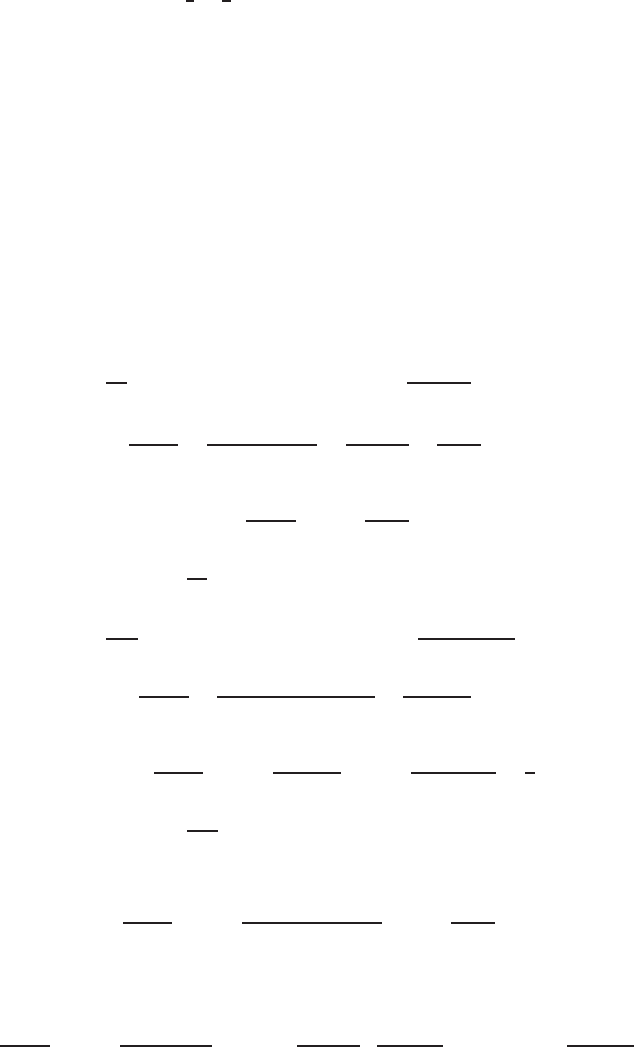
888 Chapter Nine /SOLUTIONS
54. The alternating series test requires an= sin nbe positive, which it is not. This is not an alternating series.
55. The alternating series test requires an= 2 −1/n which is positive and satisfies an+1 < anbut limn→∞ an= 2. Since
limn→∞ an6= 0, we cannot use the alternating series test.
56. We cannot use the alternating series test in this case because the absolute values of the terms are not decreasing; that is,
we do not have a series of the form P(−1)n−1anwhere an+1 < anfor every n. For example, if we look at the fourth
and fifth terms of the series, we notice that 1
2<2
3.
In fact if the terms of this series are combined in pairs, we have the harmonic series, which is divergent:
(2 −1)/1 + (2 −1)/2 + (2 −1)/3 + ···= 1 + 1/2 + 1/3 + ···.
57. The partial sums are S1= 1,S2=−1,S3= 2,S10 =−5,S11 = 6,S100 =−50,S101 = 51,S1000 =−500,
S1001 = 501, which appear to be oscillating further and further from 0. This series does not converge.
58. The partial sums look like: S1= 1,S2= 0.9,S3= 0.91,S4= 0.909,S5= 0.9091,S6= 0.90909. The series appears
to be converging to 0.909090 ...or 10/11.
Since an= 10−kis positive and decreasing and lim
n→∞ 10−n= 0, the alternating series test confirms the convergence
of the series.
59. The partial sums look like: S1= 1,S2= 0,S3= 0.5,S4= 0.3333,S5= 0.375,S10 = 0.3679,S20 = 0.3679, and
higher partial sums agree with these first 4 decimal places. The series appears to be converging to about 0.3679.
Since an= 1/n!is positive and decreasing and limn→∞ 1/n! = 0, the alternating series test confirms the conver-
gence of this series.
60. We use the ratio test with an=8n
n!.Replacing nby n+ 1 gives an+1 =8n+1
(n+ 1)! and
|an+1|
|an|=8n+1/(n+ 1)!
8n/n!=8n!
(n+ 1)! =8
n+ 1 .
Thus
L= lim
n→∞ |an+1|
|an|= lim
n→∞
8
n+ 1 = 0.
Since L < 1, the ratio test tells us that
∞
X
n=1
8n
n!converges.
61. We use the ratio test with an=n2n
3n.Replacing nby n+ 1 gives an+1 =(n+ 1)2n+1
3n+1 and
|an+1|
|an|=((n+ 1)2n+1)/3n+1
n2n/3n=2(n+ 1)
3n.
Thus
L= lim
n→∞ |an+1|
|an|= lim
n→∞
2(n+ 1)
3n= lim
n→∞
2(1 + 1/n)
3=2
3.
Since L < 1, the ratio test tells us that
∞
X
n=1
n2n
3nconverges.
62. We use the ratio test and calculate
lim
n→∞ |an+1|
|an|= lim
n→∞
(0.1)n+1/(n+ 1)!
(0.1)n/n!= lim
n→∞
0.1
n+ 1 = 0.
Since the limit is less than 1, the series converges.
63. We use the ratio test and calculate
lim
n→∞ |an+1|
|an|= lim
n→∞
n!/(n+ 1)2
(n−1)!/n2= lim
n→∞ n!
(n−1)! ·n2
(n+ 1)2= lim
n→∞ n·n2
(n+ 1)2.
Since the limit does not exist (it is ∞), the series diverges.
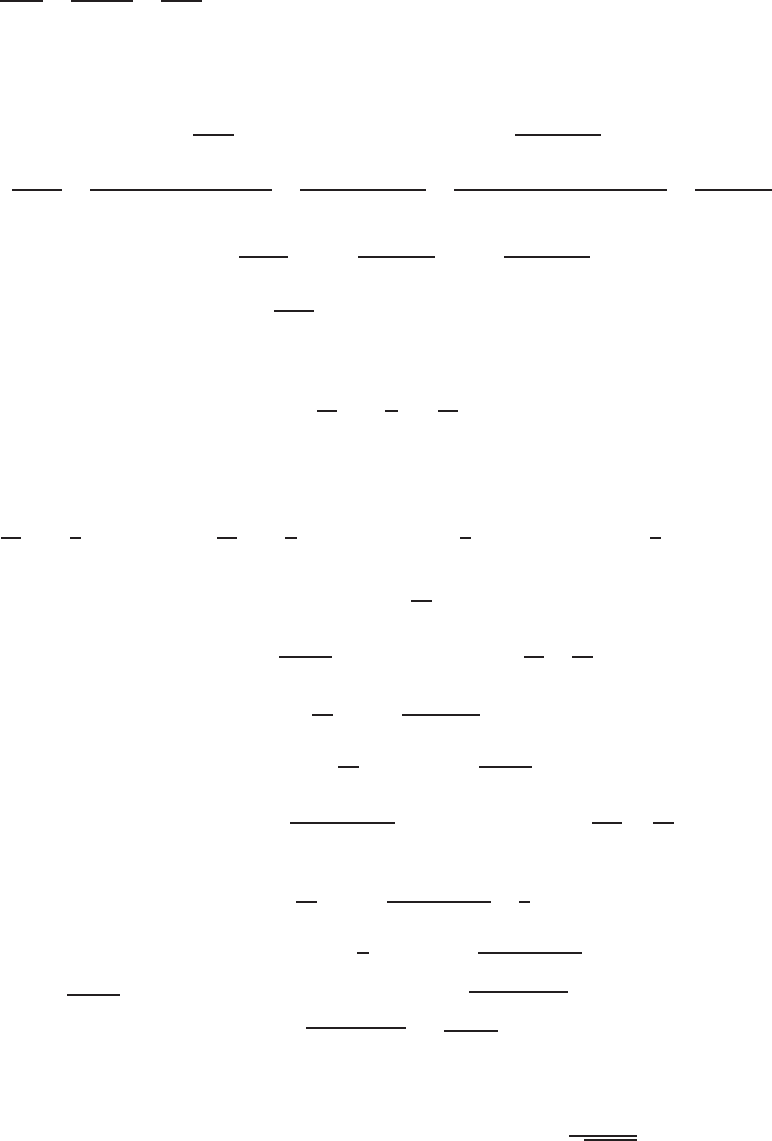
9.4 SOLUTIONS 889
64. The first few terms of the series may be written
1 + e−1+e−2+e−3+···;
this is a geometric series with a= 1 and x=e−1= 1/e. Since |x|<1, the geometric series converges to
S=1
1−x=1
1−e−1=e
e−1.
65. The first few terms of the series may be written
e+e2+e3+··· =e+e·e+e·e2+···;
this is a geometric series with a=eand x=e. Since |x|>1, this geometric series diverges.
66. We use the ratio test with an=(2n)!
(n!)2.Replacing nby n+ 1 gives an+1 =(2n+ 2)!
((n+ 1)!)2and
|an+1|
|an|=((2n+ 2)!)/((n+ 1)!)2
(2n)!/(n!)2=(2n+ 2)!(n!)2
(2n)!((n+ 1)!)2=(2n+ 2)(2n+ 1)(2n)!(n!)2
(2n)!(n+ 1)2(n!)2=2(2n+ 1)
n+ 1 .
Thus
L= lim
n→∞ |an+1|
|an|= lim
n→∞
2(2n+ 1)
n+ 1 = lim
n→∞
2(2 + 1/n)
1 + 1/n = 4.
Since L > 1, the ratio test tells us that ∞
X
n=1
(2n)!
(n!)2diverges.
67. We compare the series with the convergent series P1/n2. From the graph of tan x, we see that tan x < 2for 0≤x≤1,
so tan(1/n)<2for all n. Thus
1
n2tan 1
n<1
n22,
so the series converges, since 2P1/n2converges. Alternatively, we try the integral test. Since the terms in the series
are positive and decreasing, we can use the integral test. We calculate the corresponding integral using the substitution
w= 1/x:
Z∞
1
1
x2tan 1
xdx = lim
b→∞ Zb
1
1
x2tan 1
xdx = lim
b→∞ ln cos 1
x
b
1
= lim
b→∞ ln cos 1
b−ln(cos 1)=−ln(cos 1).
Since the limit exists, the integral converges, so the series ∞
X
n=1
1
n2tan (1/n)converges.
68. We use the limit comparison test with an=n+ 1
n3+ 6 . Because anbehaves like n
n3=1
n2as n→ ∞, we take bn= 1/n2.
We have
lim
n→∞
an
bn
= lim
n→∞
n2(n+ 1)
n3+ 6 = 1.
By the limit comparison test (with c= 1) since
∞
X
n=1
1
n2converges,
∞
X
n=1
n+ 1
n3+ 6 also converges.
69. We use the limit comparison test with an=5n+ 2
2n2+ 3n+ 7 . Because anbehaves like 5n
2n2=5
2nas n→ ∞, we take
bn= 1/n.
We have
lim
n→∞
an
bn
= lim
n→∞
n(5n+ 2)
2n2+ 3n+ 7 =5
2.
By the limit comparison test (with c= 5/2) since ∞
X
n=1
1
ndiverges, ∞
X
n=1
5n+ 2
2n2+ 3n+ 7 also diverges.
70. Let an= 1/√3n−1. Then replacing nby n+ 1 gives an+1 = 1/p3(n+ 1) −1. Since
p3(n+ 1) −1>√3n−1,
we have
an+1 < an.
In addition, limn→∞ an= 0 so the alternating series test tells us that the series
∞
X
n=1
(−1)n−1
√3n−1converges.
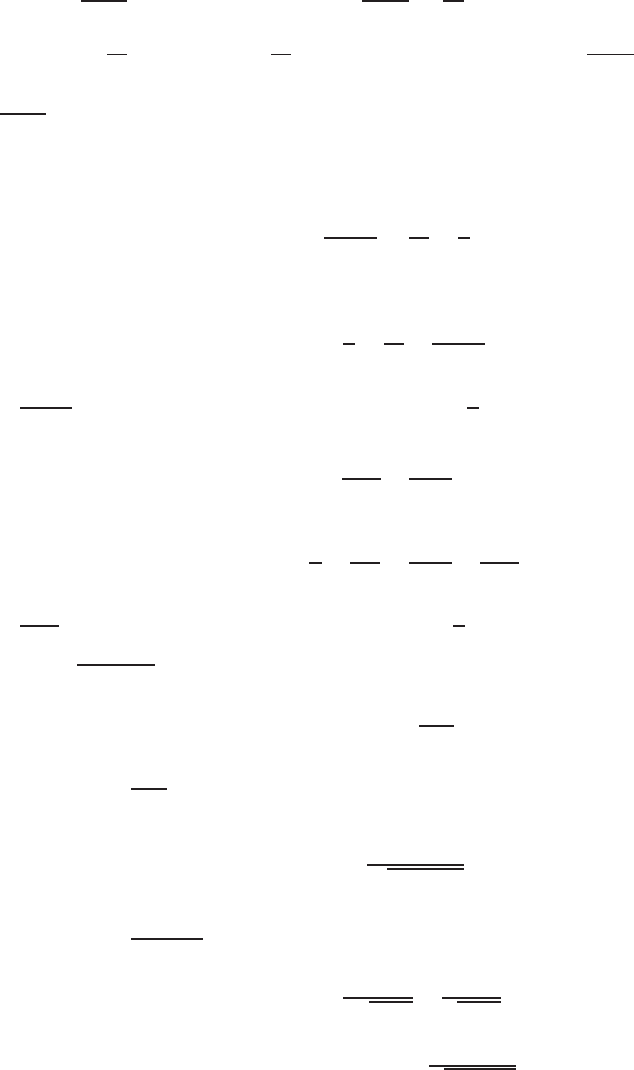
890 Chapter Nine /SOLUTIONS
71. Since the exponential, 2n, grows faster than the power, n2, the terms are growing in size. Thus, lim
n→∞ an6= 0. We conclude
that this series diverges.
72. Since 0≤ |sin n| ≤ 1for all n, we may be able to compare with 1/n2. We have 0≤ |sin n/n2| ≤ 1/n2for all n. So
P|sin n/n2|converges by comparison with the convergent series P(1/n2). Therefore P(sin n/n2)also converges,
since absolute convergence implies convergence by Theorem 9.6.
73. We take an=
sin n2
n2. Since |sin n2| ≤ 1for all n,
sin n2
n2≤1
n2.
We take bn=1
n2and
∞
X
n=1
bn=∞
X
n=1
1
n2converges. By the comparison test,
∞
X
n=1
sin n2
n2also converges. Therefore,
∞
X
n=1
sin n2
n2converges by Theorem 9.6.
74. Note that cos(nπ)/n = (−1)n/n, so this is an alternating series. Therefore, since 1/(n+ 1) <1/n and limn→∞ 1/n =
0, we see that P(cos(nπ)/n)converges by the alternating series test.
75. As n→ ∞, we see that n+ 2
n2−1→n
n2=1
n.
Since P(1/n)diverges, we expect our series to have the same behavior.
More precisely, for all n≥2, we have
0≤1
n=n
n2≤n+ 2
n2−1,
so
∞
X
n=2
n+ 2
n2−1diverges by comparison with the divergent series X1
n.
76. Since 3
ln n2=3
2 ln n,
our series behaves like the series P1/ln n. More precisely, for all n≥2, we have
0≤1
n≤1
ln n≤3
2 ln n=3
ln n2,
so ∞
X
n=2
3
ln n2diverges by comparison with the divergent series X1
n.
77. Let an= 1/pn2(n+ 2). Since n2(n+ 2) = n3+ 2n2> n3, we have
0< an<1
n3/2.
Since the p-series
∞
X
n=1
1
n3/2converges, the comparison test tells us that
∞
X
n=1
1
pn2(n+ 2)
also converges.
78. Let an=n(n+ 1)/√n3+ 2n2. Since n3+ 2n2=n2(n+ 2), we have
an=n(n+ 1)
n√n+ 2 =n+ 1
√n+ 2
so angrows without bound as n→ ∞, therefore the series
∞
X
n=1
n(n+ 1)
√n3+ 2n2diverges.
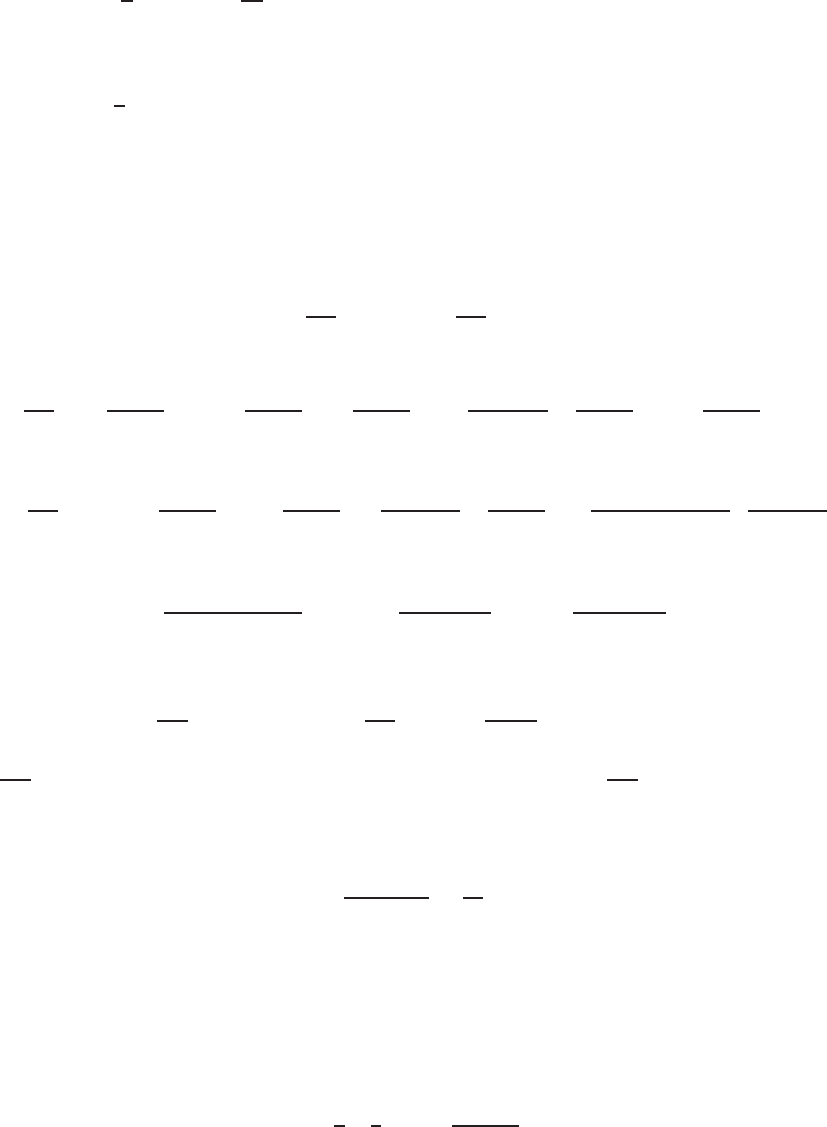
9.4 SOLUTIONS 891
79. Factoring gives
∞
X
n=1 2
na
= 2a∞
X
n=1
1
na. This is a constant times a p-series that converges if a > 1and diverges if
a≤1.
80. This is a geometric series for all a > 0, with ratio 2/a. Therefore, the series converges when 2/a < 1and diverges when
2/a ≥1. Thus ∞
X
n=12
an
converges for a > 2and diverges for a≤2.
81. This is a geometric series with ratio ln a, so it converges when |ln a|<1and diverges when |ln a| ≥ 1. We have
|ln a|<1if 1/e < a < e and |ln a| ≥ 1if a≥or a≤1/e. Thus, the series
∞
X
n=1
(ln a)nconverges for 1/e < a < e
and diverges for a≥eand 0< a ≤1/e.
82. For a > 0, the terms of the series are positive and eventually decreasing. We use the integral test and calculate the
corresponding improper integral: Z∞
1
ln x
xadx = lim
b→∞ Zb
1
lnx
xadx.
For a6= 1, use integration by parts with u= ln xand v′=x−a:
Zln x
xadx =x−a+1
−a+ 1 ln x−Zx−a
−a+ 1 dx =x−a+1
−a+ 1 ln x−x−a+1
(−a+ 1)2=x−a+1
−a+ 1 ln x−1
−a+ 1 .
Thus,
lim
b→∞ Zb
1
lnx
xadx = lim
b→∞ b−a+1
−a+ 1 ln b−1
−a+ 1 +1
(−a+ 1)2=1
−a+ 1 lim
b→∞
ln b−1/(−a+ 1)
ba−1+1
(−a+ 1)2.
Use l’Hopital’s Rule to obtain
lim
b→∞ ln b−1/(−a+1)
ba−1= lim
b→∞ 1/b
(a−1)ba−2= lim
b→∞
1
(a−1)ba−1.
This limit exists for a−1>0and does not exist for a−1<0. Thus the series converges for a > 1and diverges for
0< a < 1.
For a= 1, the series
∞
X
n=1
ln n
ndiverges because Z∞
1
lnx
xdx = lim
b→∞
(ln x)2
2
b
1
,and this limit diverges. For a≤0,
lim
n→∞
ln n
nadoes not exist, so the series diverges by Property 3 of Theorem 9.2. Thus ∞
X
n=1
ln n
nconverges for a > 1and
diverges for a≤1.
83. To use the alternating series test, consider an=f(n), where f(x) = arctan(a/x). We need to show that f(x)is
decreasing. Since
f′(x) = 1
1 + (a/x)2−a
x2,
we have f′(x)<0for a > 0, so f(x)is decreasing for all x. Thus an+1 < anfor all n, and as lim
n→∞ arctan(a/n) = 0
for all a, by the alternating series test,
∞
X
n=1
(−1)narctan(a/n)
converges.
84. The nth partial sum of the series is given by
Sn= 1 −1
2+1
3− ··· +(−1)n−1
n,
so the absolute value of the first term omitted is 1/(n+ 1). By Theorem 9.9, we know that the value, S, of the sum differs
from Snby less than 1/(n+1). Thus, we want to choose nlarge enough so that 1/(n+1) ≤0.01. Solving this inequality
for nyields n≥99, so we take 99 or more terms in our partial sum.

892 Chapter Nine /SOLUTIONS
85. The nth partial sum of the series is given by
Sn= 1 −2
3+4
9− ··· + (−1)(n−1) 2
3(n−1)
,
so the absolute value of the first term omitted is (2/3)n. By Theorem 9.9, we know that the value, S, of the sum differs
from Snby less than (2/3)n. Thus, we want to choose nlarge enough so that (2/3)n≤0.01. Solving this inequality
for nyields n≥11.358, so taking 12 or more terms in our partial sum is guaranteed to be within 0.01 of the sum of the
series.
Note: Since this is a geometric series, we know the exact sum to be 1/(1+2/3) = 0.6.The partial sum S12 is 0.595,
which is indeed within 0.01 of the sum of the series. Note, however, that S11 = 0.6069,which is also within 0.01 of the
exact sum of the series. Theorem 9.9 gives us a value of nfor which Snis guaranteed to be within a small tolerance of
the sum of an alternating series, but not necessarily the smallest such value.
86. The nth partial sum of the series is given by
Sn=1
2−1
24 +1
720 − ··· +(−1)n−1
(2n)! ,
so the absolute value of the first term omitted is 1/(2n+ 2)!. By Theorem 9.9, we know that the value, S, of the sum
differs from Snby less than 1/(2n+2)!. Thus, we want to choose nlarge enough so that 1/(2n+2)! ≤0.01. Substituting
n= 2 into the expression 1/(2n+ 2)! yields 1/720 which is less than 0.01. We therefore take 2 or more terms in our
partial sum.
87. Since 0≤cn≤2−nfor all n, and since P2−nis a convergent geometric series, Pcnconverges by the Comparison
Test. Similarly, since 2n≤an, and since P2nis a divergent geometric series, Pandiverges by the Comparison Test.
We do not have enough information to determine whether or not Pbnand Pdnconverge.
88. (a) The sum Pan·bn=P1/n5, which converges, as a p-series with p= 5, or by the integral test:
Z∞
1
1
x5dx = lim
b→∞
x−4
(−4)
b
1
=lim
b→∞
b−4
(−4) +1
4=1
4.
Since this improper integral converges, Pan·bnalso converges.
(b) This is an alternating series that satisfies the conditions of the alternating series test: the terms are decreasing and
have limit 0,so P(−1)n/√nconverges.
(c) We have anbn= 1/n, so Panbnis the harmonic series, which diverges.
89. Since lim
n→∞ an/bn= 0, for large enough nwe have |an/bn|<1/2and thus 0≤ |an|< bn/2< bn. By the
comparison test applied to P|an|and Pbn, the series P|an|converges. The series Panconverges absolutely and
thus it converges.
90. Since lim
n→∞ an/bn=∞, for large enough nwe have an/bn>1and thus an> bn. By the comparison test applied to
Panand Pbn, the series Pandiverges.
91. Each term in Pbnis greater than or equal to a1times a term in the harmonic series:
b1=a1·1
b2=a1+a2
2> a1·1
2
b3=a1+a2+a3
3> a1·1
3
.
.
.
bn=a1+a2+···+an
n> a1·1
n
Adding these inequalities gives Xbn>a1X1
n.
Since the harmonic series P1/n diverges, a1times the harmonic series also diverges. Then, by the comparison test, the
series Pbndiverges.

9.4 SOLUTIONS 893
92. Suppose we let cn= (−1)nan. (We have just given the terms of the series P(−1)nana new name.) Then
|cn|=|(−1)nan|=|an|.
Thus P|cn|converges, and by Theorem 9.6,
Xcn=X(−1)nanconverges.
93. (a) Since
|an|=anif an≥0
|an|=−anif an<0,
we have
an+|an|= 2|an|if an≥0
an+|an|= 0 if an<0.
Thus, for all n,
0≤an+|an| ≤ 2|an|.
(b) If P|an|converges, then P2|an|is convergent, so, by comparison, P(an+|an|)is convergent. Then
X((an+|an|)− |an|) = Xan
is convergent, as it is the difference of two convergent series.
94. The limit
lim
n→∞
n
√an= lim
n→∞
2
n= 0 <1,
so the series converges.
95. The limit
lim
n→∞
n
√an= lim
n→∞
5n+ 1
3n2= 0 <1,
so the series converges.
Strengthen Your Understanding
96. The series is not alternating since (−1)2n= 1 for all n > 0, so we cannot use the alternating series test. The series is the
same as P1/n2which converges by the p-test with p= 2.
97. We could show the series converges by comparison with the convergent series P1/n2. The ratio test gives
lim
n→∞
(1/((n+ 1)2+ 1)
1/(n2+ 1) = lim
n→∞
n2+ 1
(n+ 1)2+ 1 = lim
n→∞
1 + 1/n2
((n+ 1)/n)2+ 1/n2=1 + 0
1 + 0 = 1.
The ratio test is inconclusive when the limit of the ratios is 1.
98. It is true that the comparison series P1/n2converges, but in order to make the comparison, we need 1/n3/2≤1/n2
for all n; we have instead 1/n3/2>1/n2for all n > 1.
99. If we want the series P∞
n=1 anand P∞
n=1 |an|to behave differently, then we need anto be negative for some values of
n. Thus we try an alternating series.
The series P∞
n=1(−1)n/n works. Because this series is of the form P∞
n=1(−1)nbnwhere bn>0for all nand
bn+1 < bnfor all nand also bn→0, the series converges by the alternating series test.
However, the series P∞
n=1 |an|=P∞
n=1 1/n diverges by the p-series test.
100. The following series is alternating: Xan=X(−1)nn,
but since the terms do not tend to 0 as n→ ∞, the series does not converge.
101. The geometric series with an= 3nsatisfies this condition.
102. False. The sequence −1,1,−1,1, . . . given by sn= (−1)nalternates in sign but does not converge.

894 Chapter Nine /SOLUTIONS
103. False. It does not tell us anything to know that bnis larger than a convergent series. For example, if an= 1/n2and
bn= 1, then 0≤an≤bnand Panconverges, but Pbndiverges. Since this statement is not true for all anand bn,
the statement is false.
104. True. This is one of the statements of the comparison test.
105. True. Consider the series P(−bn)and P(−an). The series P(−bn)converges, since Pbnconverges, and
0≤ −an≤ −bn.
By the comparison test, P(−an)converges, so Panconverges.
106. False. It is true that if P|an|converges, then we know that Panconverges. However, knowing that Panconverges
does not tell us that P|an|converges.
For example, if an= (−1)n−1/n, then Panconverges by the alternating series test. However, P|an|is the
harmonic series which diverges.
107. False. For example, if an= 1/n2, then
lim
n→∞ |an+1|
|an|= lim
n→∞
1/(n+ 1)2
1/n2= lim
n→∞
n2
(n+ 1)2= 1.
However, P1/n2converges.
108. True, since if we write out the terms of the series, using the fact that cos(2πn) = 1 for all n, we have
(−1)0cos 0 + (−1)1cos(2π) + (−1)2cos(4π) + (−1)3cos(6π) + ···
= 1 ·1−1·1 + 1 ·1−1·1 + ···
= 1 −1 + 1 −1 + ···.
This is an alternating series.
109. False. This is an alternating series, but since the terms do not go to zero, it does not converge.
110. False. For example, if an= (−1)n−1/n, then Panconverges by the alternating series test. But (−1)nan= (−1)n(−1)n−1/n =
(−1)2n−1/n =−1/n. Thus, P(−1)nanis the negative of the harmonic series and does not converge.
111. This is true. It is a restatement of Theorem 9.9.
112. This statement is false. The statement is true if the series converges by the alternating series test, but not in general.
Consider, for example, the alternating series
S= 10 −0.01 + 0.8−0.7−0 + 0 −0 + ···.
Since the later terms are all 0, we can find the sum exactly:
S= 10.69.
If we approximated the sum by the first term, S1= 10, the magnitude of the first term omitted would be 0.01. Thus, if
the statement in this problem were true, we would say that the true value of the sum lay between 10 + 0.01 = 10.01 and
10 −0.01 = 9.99 which it does not.
113. True. Let cn= (−1)n|an|. Then |cn|=|an|so P|cn|converges, and therefore Pcn=P(−1)n|an|converges.
114. True. Since the series is alternating, Theorem 9.9 gives the error bound. Summing the first 100 terms gives S100, and if
the true sum is S,
|S−S100|< a101 =1
101 <0.01.
115. True. If P|an|is convergent, then so is Pan.
116. False. The alternating harmonic series X(−1)n
nis conditionally convergent because it converges by the Alternating
Series test, but the harmonic series X
(−1)n
n=X1
nis divergent. The alternating harmonic series is not absolutely
convergent.
117. True. By the comparison test, if Panis larger term-by-term than a divergent series, then Pandiverges. If Pbn
diverges, then so does P0.5bn.
118. (b). This series should be compared with
∞
X
k=1
1
k3.

9.5 SOLUTIONS 895
Solutions for Section 9.5
Exercises
1. Yes.
2. No, because it contains negative powers of x.
3. No, each term is a power of a different quantity.
4. Yes. It’s a polynomial, or a series with all coefficients beyond the 7th being zero.
5. The general term can be written as 1·3·5···(2n−1)
2n·n!xnfor n≥1. Other answers are possible.
6. The general term can be written as p(p−1)(p−2) ···(p−n+ 1)
n!xnfor n≥1. Other answers are possible.
7. The general term can be written as (−1)k(x−1)2k
(2k)! for k≥0. Other answers are possible.
8. The general term can be written as (−1)k+1(x−1)2k+1
(2(k−1))! for k≥1or as (−1)k(x−1)2k+3
(2k)! for k≥0. Other answers
are possible.
9. The general term can be written as (x−a)n
2n−1·n!for n≥1. Other answers are possible.
10. The general term can be written as (k+ 1)(x+ 5)2k+1
(k−1)! for k≥1or as (k+ 2)(x+ 5)2k+3
k!for k≥0. Other answers
are possible.
11. Since Cn=n, replacing nby n+ 1 gives Cn+1 =n+ 1. Using the ratio test with an=nxn, we have
lim
n→∞ |an+1|
|an|=|x|lim
n→∞ |Cn+1|
|Cn|=|x|lim
n→∞
n+ 1
n=|x|.
Thus the radius of convergence is R= 1.
12. This series may be written as
1 + 5x+ 25x2+···
so Cn= 5n. Using the ratio test, with an= 5nxn, we have
lim
n→∞ |an+1|
|an|=|x|lim
n→∞ |Cn+1|
|Cn|=|x|lim
n→∞
5n+1
5n= 5|x|.
Thus the radius of convergence is R= 1/5.
13. Since Cn=n3, replacing nby n+ 1 gives Cn+1 = (n+ 1)3. Using the ratio test, with an=n3xn, we have
|an+1|
|an|=|x||Cn+1|
|Cn|=|x|(n+ 1)3
n3=|x|n+ 1
n3
.
We have
lim
n→∞ |an+1|
|an|=|x|.
Thus the radius of convergence is R= 1.
14. Let Cn= 2n+n2. Then replacing nby n+ 1 gives Cn+1 = 2n+1 + (n+ 1)2. Using the ratio test, we have
|an+1|
|an|=|x||Cn+1|
|Cn|=|x|2n+1 + (n+ 1)2
2n+n2= 2|x|2n+1
2(n+ 1)2
2n+n2.
Since 2ndominates n2as n→ ∞, we have
lim
n→∞ |an+1|
|an|= 2|x|.
Thus the radius of convergence is R=1
2.
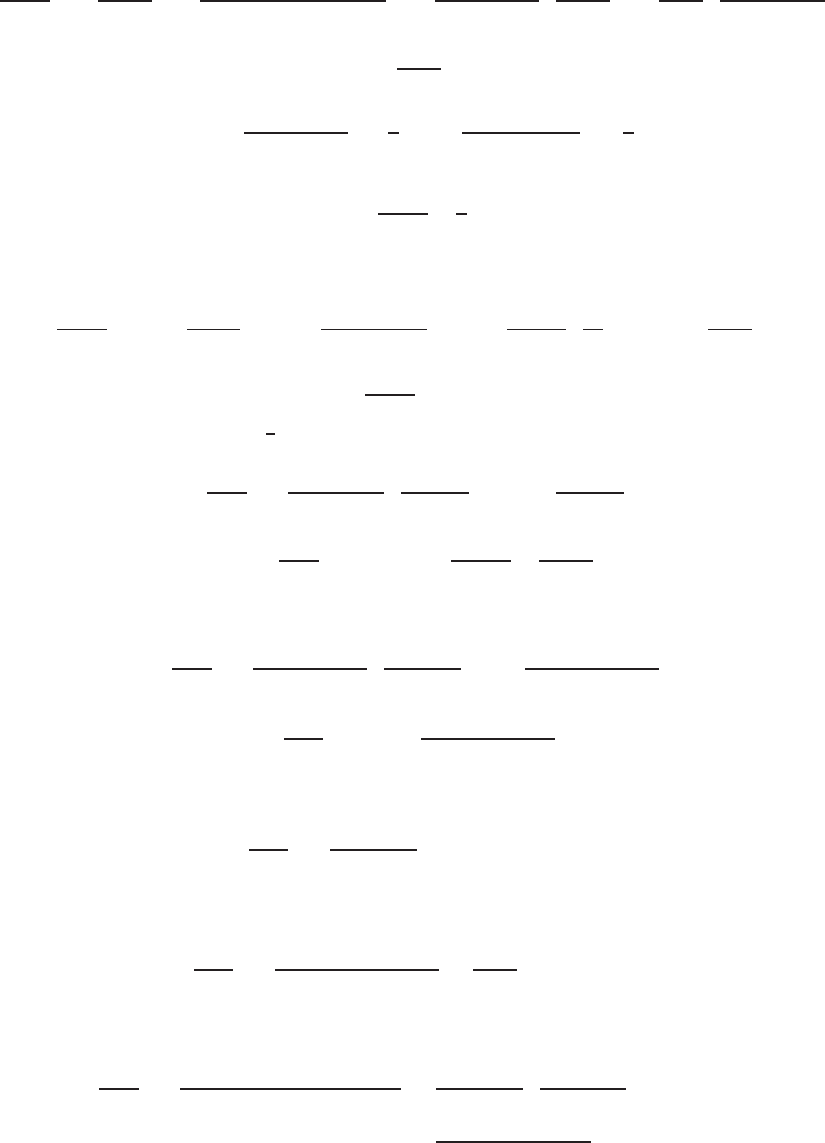
896 Chapter Nine /SOLUTIONS
15. Since Cn= (n+ 1)/(2n+n), replacing nby n+ 1 gives Cn+1 = (n+ 2)/(2n+1 +n+ 1). Using the ratio test, we
have
|an+1|
|an|=|x||Cn+1|
|Cn|=|x|(n+ 2)/(2n+1 +n+ 1)
(n+ 1)/(2n+n)=|x|n+ 2
2n+1 +n+ 1 ·2n+n
n+ 1 =|x|n+ 2
n+ 1 ·2n+n
2n+1 +n+ 1 .
Since
lim
n→∞
n+ 2
n+ 1 = 1
and
lim
n→∞ 2n+n
2n+1 +n+ 1 =1
2lim
n→∞ 2n+n
2n+ (n+ 1)/2=1
2,
because 2ndominates nas n→ ∞, we have
lim
n→∞ |an+1|
|an|=1
2|x|.
Thus the radius of convergence is R= 2.
16. Since Cn= 2n/n, replacing nby n+ 1 gives Cn+1 = 2n+1/(n+ 1). Using the ratio test, we have
|an+1|
|an|=|x−1||Cn+1|
|Cn|=|x−1|2n+1/(n+ 1)
2n/n =|x−1|2n+1
(n+ 1) ·n
2n= 2|x−1|n
n+ 1 ,
so
lim
n→∞ |an+1|
|an|= 2|x−1|.
Thus the radius of convergence is R=1
2.
17. We use the ratio test:
an+1
an=
(x−3)n+1
(n+ 1)2n+1 ·n2n
(x−3)n=|x−3|n
2(n+ 1) .
Therefore, we have
lim
n→∞
an+1
an=|x−3|lim
n→∞
n
2(n+ 1 =|x−3|
2.
Thus by the ratio test, the series converges if |x−3|/2<1, that is |x−3|<2. The radius of convergence is R= 2.
18. We use the ratio test:
an+1
an=
(−1)n+1x2n+2
(2n+ 2)! ·(2n)!
(−1)nx2n=|x2|1
(2n+ 2)(2n+ 1) .
Therefore we have
lim
n→∞
an+1
an=x2lim
n→∞
1
(2n+ 2)(2n+ 1) = 0.
Thus, by the ratio test, the series converges for all x, so the radius of convergence is R=∞.
19. The coefficient of the nth term is Cn= (−1)n+1/n2. Now consider the ratio
an+1
an=
n2xn+1
(n+ 1)2xn→ |x|as n→ ∞.
Thus, the radius of convergence is R= 1.
20. Here the coefficient of the nth term is Cn= (2n/n!).Now we have
an+1
an=
(2n+1/(n+ 1)!)xn+1
(2n/n!)xn=2|x|
n+ 1 →0as n→ ∞.
Thus, the radius of convergence is R=∞, and the series converges for all x.
21. Here Cn= (2n)!/(n!)2.We have:
an+1
an=
(2(n+ 1))!/((n+ 1)!)2xn+1
(2n)!/(n!)2xn=(2(n+ 1))!
(2n)! ·(n!)2
((n+ 1)!)2|x|
=(2n+ 2)(2n+ 1)|x|
(n+ 1)2→4|x|as n→ ∞.
Thus, the radius of convergence is R= 1/4.
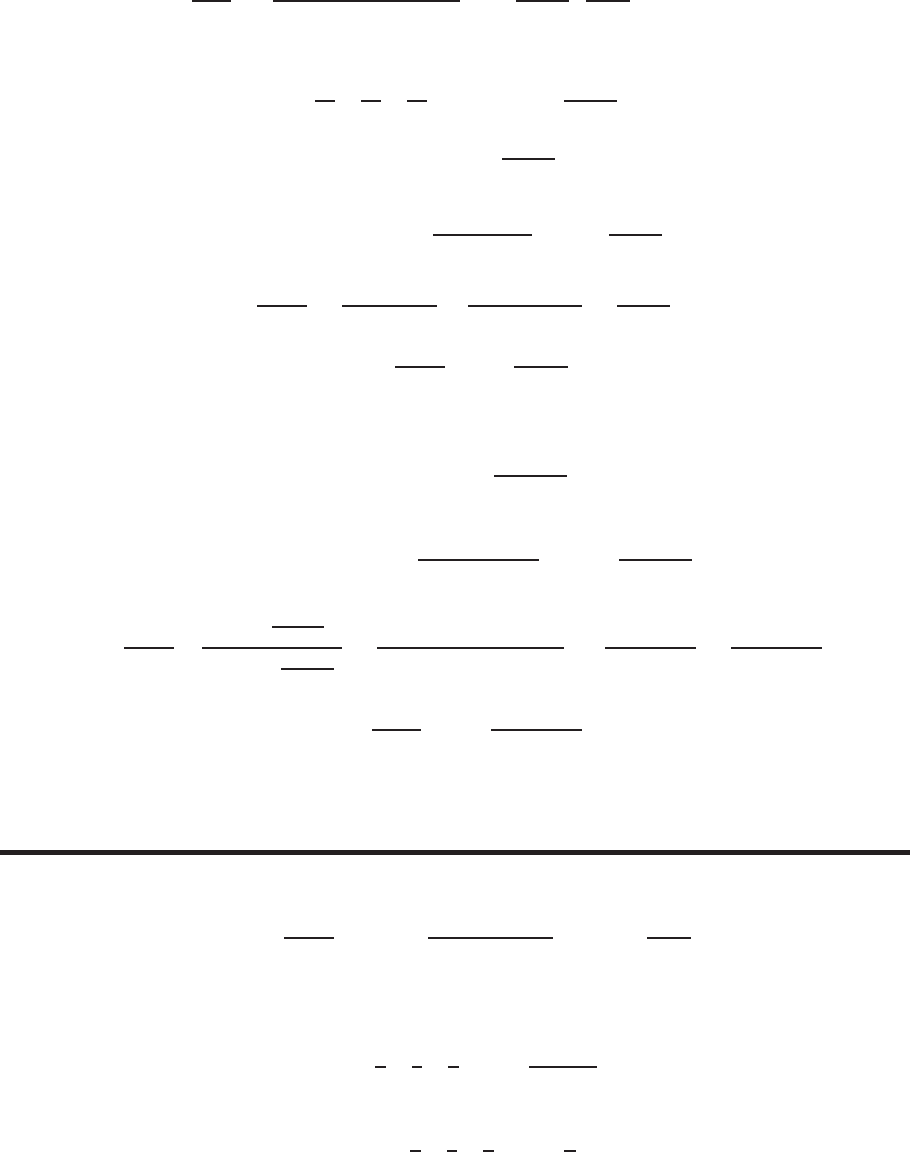
9.5 SOLUTIONS 897
22. Here the coefficient of the nth term is Cn= (2n+ 1)/n. Applying the ratio test, we consider:
an+1
an=
((2n+ 3)/(n+ 1))xn+1
((2n+ 1)/n)xn=|x|2n+ 3
2n+ 1 ·n
n+ 1 → |x|as n→ ∞.
Thus, the radius of convergence is R= 1.
23. We write the series as
x−x3
3+x5
5−x7
7+·· · + (−1)n−1x2n−1
2n−1+···,
so
an= (−1)n−1x2n−1
2n−1.
Replacing nby n+ 1, we have
an+1 = (−1)n+1−1x2(n+1)−1
2(n+ 1) −1= (−1)nx2n+1
2n+ 1 .
Thus
|an+1|
|an|=
(−1)nx2n+1
2n+ 1 ·
2n−1
(−1)n−1x2n−1=2n−1
2n+ 1 x2,
so
L= lim
n→∞ |an+1|
|an|= lim
n→∞
2n−1
2n+ 1 x2=x2.
By the ratio test, this series converges if L < 1, that is, if x2<1, so R= 1.
24. As seen in Example 7, we can write the general term of the series as
an= (−1)n−1x2n−1
(2n−1)! ,
so that, replacing nby n+ 1, we have
an+1 = (−1)(n+1)−1x2(n+1)−1
(2 (n+ 1) −1)! = (−1)nx2n+1
(2n+ 1)! .
Thus,
|an+1|
|an|=(−1)nx2n+1
(2n+1)!
(−1)n−1x2n−1
(2n−1)!
=
(−1)nx2n+1(2n−1)!
(−1)n−1x2n−1(2n+ 1)! =
(−1) x2
(2n+ 1) 2n=x2
(2n+ 1) 2n.
Because
lim
n→∞ |an+1|
|an|= lim
n→∞
x2
(2n+ 1) 2n= 0,
we have limn→∞ |an+1|/|an|= 0 <1for all x. Thus, the ratio test guarantees that the power series converges for every
real number x. The radius of convergence is infinite and the interval of convergence is all x.
Problems
25. (a) The general term of the series is xn/n if nis odd and −xn/n if nis even, so Cn= (−1)n−1/n, and we can use the
ratio test. We have
lim
n→∞ |an+1|
|an|=|x|lim
n→∞ |(−1)n/(n+ 1)|
|(−1)n−1/n|=|x|lim
n→∞
n
n+ 1 =|x|.
Therefore the radius of convergence is R= 1. This tells us that the power series converges for |x|<1and does not
converge for |x|>1.Notice that the radius of convergence does not tell us what happens at the endpoints, x=±1.
(b) The endpoints of the interval of convergence are x=±1. At x= 1, we have the series
1−1
2+1
3−1
4+···+(−1)n−1
n+···
This is an alternating series with an= 1/n, so by the alternating series test, it converges. At x=−1, we have the
series
−1−1
2−1
3−1
4− ·· · − 1
n− ···
This is the negative of the harmonic series, so it does not converge. Therefore the right endpoint is included, and the
left endpoint is not included in the interval of convergence, which is −1< x ≤1.
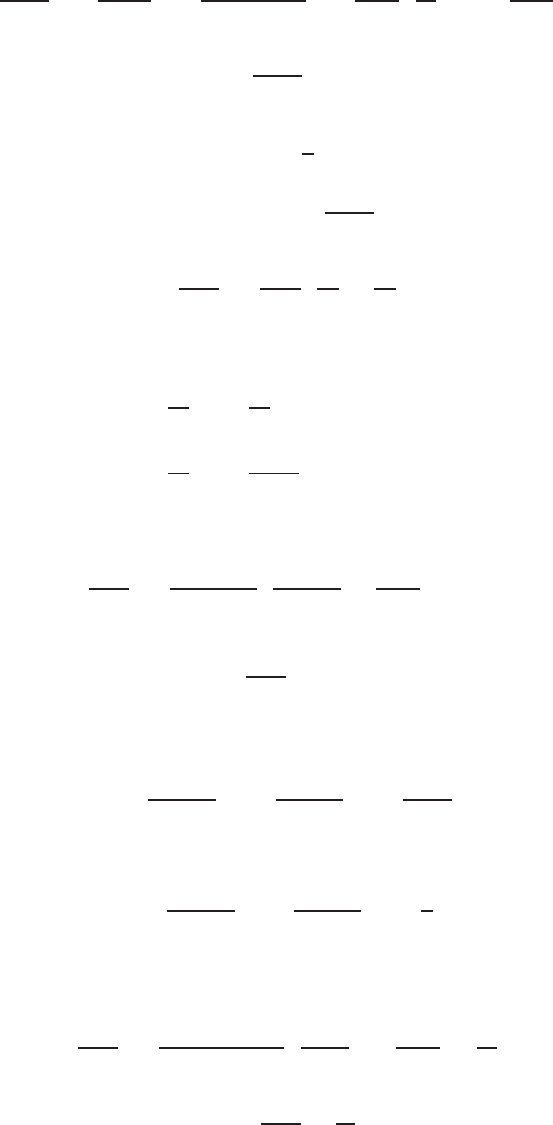
898 Chapter Nine /SOLUTIONS
26. Let Cn= 2n/n. Then replacing nby n+ 1 gives Cn+1 = 2n+1/(n+ 1). Using the ratio test, we have
|an+1|
|an|=|x||Cn+1|
|Cn|=|x|2n+1/(n+ 1)
2n/n =|x|2n+1
n+ 1 ·n
2n= 2|x|n
n+ 1 .
Thus
lim
n→∞ |an+1|
|an|= 2|x|.
The radius of convergence is R= 1/2.
For x= 1/2the series becomes the harmonic series ∞
X
n=1
1
nwhich diverges.
For x=−1/2the series becomes the alternating series
∞
X
n=1
(−1)n
nwhich converges. See Example 8 on page 517.
27. We use the ratio test:
an+1
an=
xn+1
3n+1 ·3n
xn=|x|
3.
Since |x|/3<1when |x|<3, the radius of convergence is 3 and the series converges for −3< x < 3.
We check the endpoints:
x= 3 : ∞
X
n=0
xn
3n=∞
X
n=0
3n
3n=∞
X
n=0
1nwhich diverges.
x=−3 : ∞
X
n=0
xn
3n=∞
X
n=0
(−3)n
3n=∞
X
n=0
(−1)nwhich diverges.
The series diverges at both the endpoints, so the interval of convergence is −3< x < 3.
28. We use the ratio test:
an+1
an=
(x−3)n+1
n+ 1 ·n
(x−3)n=n
n+ 1 · |x−3|.
Since n/(n+ 1) →1as n→ ∞, we have
lim
n→∞
an+1
an=|x−3|.
The series converges for |x−3|<1. The radius of convergence is 1 and the series converges for 2< x < 4.
We check the endpoints. For x= 2, we have
∞
X
n=2
(x−3)n
n=∞
X
n=2
(2 −3)n
n=∞
X
n=2
(−1)n
n.
This is the alternating harmonic series and converges. For x= 4, we have
∞
X
n=2
(x−3)n
n=∞
X
n=2
(4 −3)n
n=∞
X
n=2
1
n.
This is the harmonic series and diverges. The series converges at x= 2 and diverges at x= 4. Therefore, the interval of
convergence is 2≤x < 4.
29. We use the ratio test:
an+1
an=
(n+ 1)2x2(n+1)
22(n+1) ·22n
n2x2n=n+ 1
n2
·x2
4.
Since (n+ 1)/n →1as n→ ∞, we have
lim
n→∞
an+1
an=x2
4.
We have x2/4<1when |x|<2. The radius of convergence is 2 and the series converges for −2< x < 2.
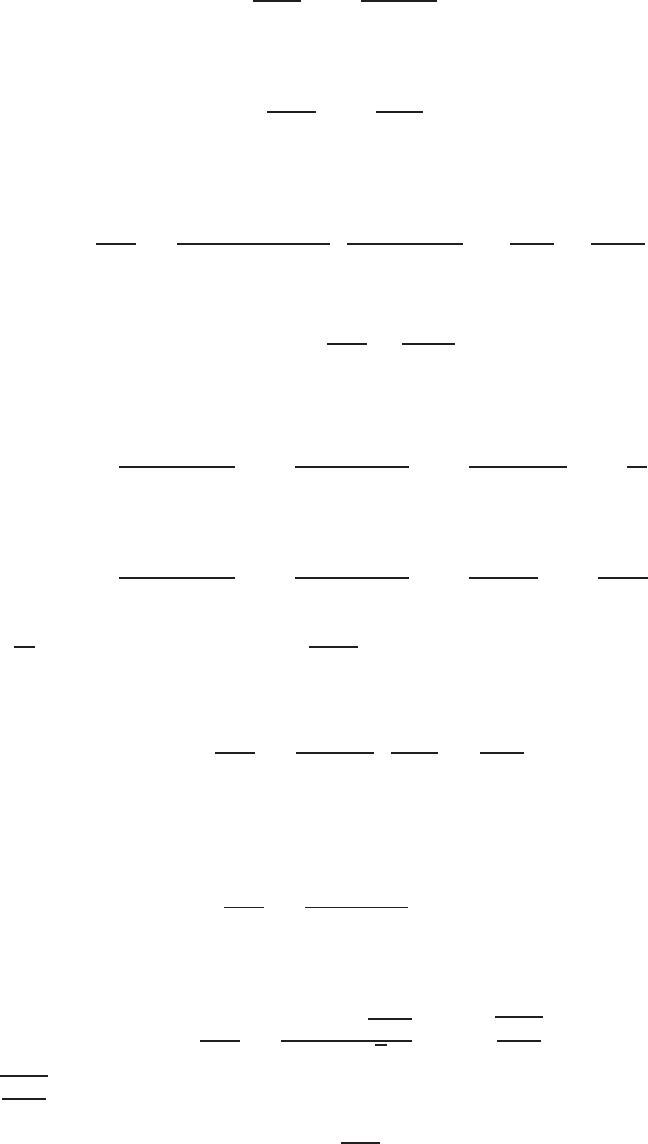
9.5 SOLUTIONS 899
We check the endpoints. For x=−2, we have
∞
X
n=1
n2x2n
22n=∞
X
n=1
n2(−2)2n
22n=∞
X
n=1
n2,
which diverges. Similarly, for x= 2, we have
∞
X
n=1
n2x2n
22n=∞
X
n=1
n222n
22n=∞
X
n=1
n2,
which diverges. The series diverges at both endpoints, so the interval of convergence is −2< x < 2.
30. We use the ratio test:
an+1
an=
(−1)n+1(x−5)n+1
2n+1(n+ 1)2·2nn2
(−1)n(x−5)n=n
n+ 1 2
·|x−5|
2.
Since n/(n+ 1) →1as n→ ∞, we have
lim
n→∞
an+1
an=|x−5|
2.
We have |x−5|/2<1when |x−5|<2. The radius of convergence is 2 and the series converges for 3< x < 7.
We check the endpoints. For x= 3, we have
∞
X
n=1
(−1)n(x−5)n
2nn2=∞
X
n=1
(−1)n(3 −5)n
2nn2=∞
X
n=1
(−1)n(−2)n
2nn2=∞
X
n=1
1
n2.
This is a p-series with p= 2 and it converges. For x= 7, we have
∞
X
n=1
(−1)n(x−5)n
2nn2=∞
X
n=1
(−1)n(7 −5)n
2nn2=∞
X
n=1
(−1)n2n
2nn2=∞
X
n=1
(−1)n
n2.
Since X1
n2converges, the alternating series X(−1)n
n2also converges. The series converges at both its endpoints, so
the interval of convergence is 3≤x≤7.
31. We use the ratio test to find the radius of convergence;
an+1
an=
x2(n+1)+1
(n+ 1)! ·n!
x2n+1 =
x2
n+ 1
Since limn→∞ |x2|/(n+ 1) = 0 for all x, the radius of convergence is R=∞. There are no endpoints to check. The
interval of convergence is all real numbers −∞ < x < ∞.
32. We use the ratio test to find the radius of convergence
an+1
an=
(n+ 1)!xn+1
n!xn=|x|(n+ 1).
Since limn→∞ |x|(n+ 1) = ∞for all x6= 0, the radius of convergence is R= 0. There are no endpoints to check. The
series converges only for x= 0, so the interval of convergence is the single point x= 0.
33. We use the ratio test:
an+1
an=
(5x)n+1/√n+ 1
(5x)n/√n= 5|x|rn
n+ 1 .
Since rn
n+ 1 →1as n→ ∞, we have
lim
n→∞
an+1
an= 5|x|.
We have 5|x|<1when |x|<1/5. The radius of convergence is 1/5and the series converges for −1/5< x < 1/5.
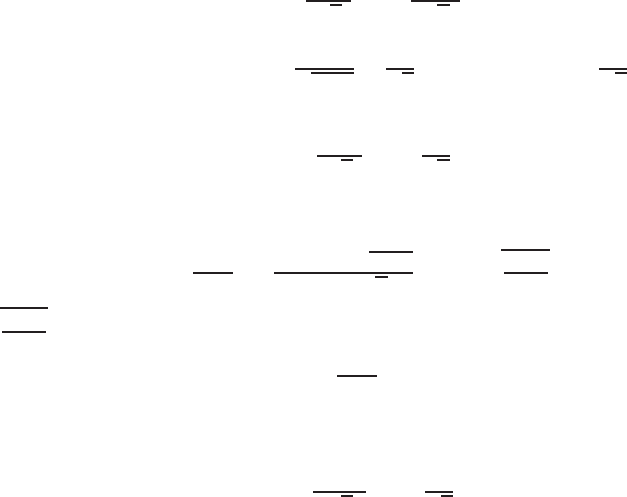
900 Chapter Nine /SOLUTIONS
We check the endpoints. For x=−1/5, we have
∞
X
n=1
(5x)n
√n=∞
X
n=1
(−1)n
√n.
This is an alternating series. Since we have 0<1
√n+ 1 <1
√nfor all n≥1and lim
n→∞
1
√n= 0, by the alternating
series test, the series converges at the endpoint x=−1/5. For x= 1/5, we have
∞
X
n=1
(5x)n
√n=∞
X
n=1
1
√n.
This is a p-series with p= 1/2and it diverges. Therefore, the interval of convergence is −1/5≤x < 1/5.
34. We use the ratio test:
an+1
an=
(5x)2n+2/√n+ 1
(5x)2n/√n= 52x2rn
n+ 1 .
Since rn
n+ 1 →1as n→ ∞, we have
lim
n→∞
an+1
an= 25x2.
We have 25x2<1when |x|<1/5. The radius of convergence is 1/5and the series converges for −1/5< x < 1/5.
We check the endpoints. For x=±1/5, we have
∞
X
n=1
(5x)2n
√n=∞
X
n=1
1
√n.
This is a p-series with p= 1/2and it diverges. The series diverges at both endpoints x=±1/5, so the interval of
convergence is −1/5≤x < 1/5.
35. The expression 1/(1 + 2z)has the form a/(1 −x), which is the sum of a geometric series with a= 1,x=−2z. The
power series is
1 + (−2z) + (−2z)2+ (−2z)3+···=∞
X
n=0
(−2z)n.
This series converges for | − 2z|<1, that is, for −1/2< z < 1/2.
36. The expression 2/(1 + y2)has the form a/(1 −x), which is the sum of a geometric series with a= 2,x=−y2. The
power series is
2 + (−y2) + (−y2)2+ (−y2)3+···=∞
X
n=0
2(−y2)n.
This series converges for | − y2|<1, that is, for −1< y < 1.
37. The expression 3/(1 −z/2) has the form a/(1 −x), which is the sum of a geometric series with a= 3,x=z/2. The
power series is
3 + 3(z/2) + 3(z/2)2+ 3(z/2)3+··· =∞
X
n=0
3(z/2)n.
This series converges for |z/2|<1, that is, for −2< z < 2.
38. To compare 8/(4 + y)with a/(1 −x), divide the numerator and denominator by 4. This gives 8/(4 + y) = 2/(1 + y/4),
which is the sum of a geometric series with a= 2,x=−y/4. The power series is
2 + 2(−y/4) + 2(−y/4)2+ 2(−y/4)3+···=∞
X
n=0
2(−y/4)n.
This series converges for |y/4|<1, that is, for −4< y < 4.
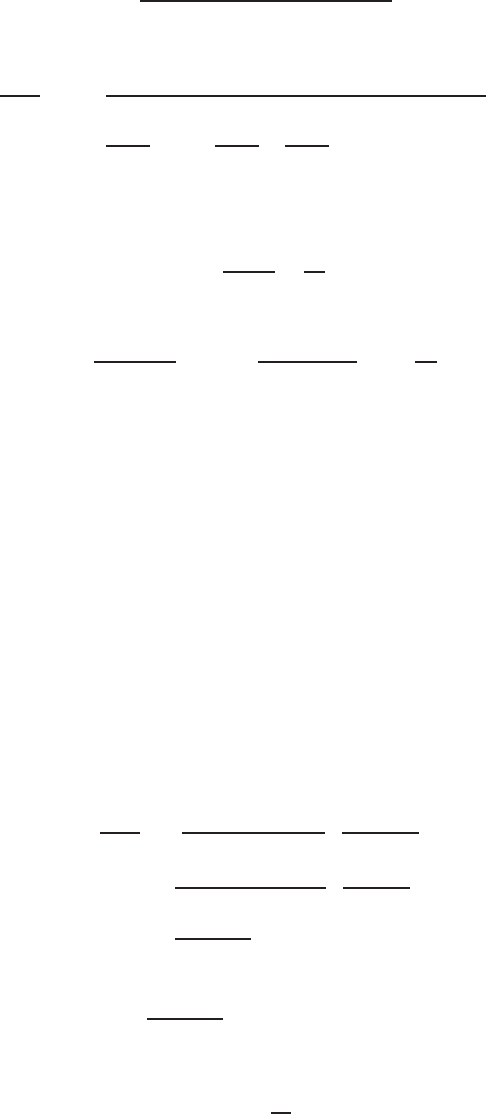
9.5 SOLUTIONS 901
39. The coefficient of the nth term of the binomial power series is given by
Cn=p(p−1)(p−2) ···(p−(n−1))
n!.
To apply the ratio test, consider
an+1
an=|x|
p(p−1)(p−2) ···(p−(n−1))(p−n)/(n+ 1)!
p(p−1)(p−2) ···(p−(n−1))/n!
=|x|
p−n
n+ 1 =|x|
p
n+ 1 −n
n+ 1 → |x|as n→ ∞.
Thus, the radius of convergence is R= 1.
40. The kth coefficient in the series PkCkxkis Dk=k·Ck. We are given that the series PCkxkhas radius of convergence
Rby the ratio test, so
|x|lim
k→∞ |Ck+1|
|Ck|=|x|
R.
Thus, applying the ratio test to the new series, we have
lim
k→∞
Dk+1xk+1
Dkxk= lim
k→∞
(k+ 1)Ck+1
kCk|x|=|x|
R.
Hence the new series has radius of convergence R.
41. The radius of convergence, R, is between 5and 7.
42. The series is centered at x=−7. Since the series converges at x= 0, which is a distance of 7 from x=−7, the radius
of convergence, R, is at least 7. Since the series diverges at x=−17, which is a distance of 10 from x=−7, the radius
of convergence is no more than 10. That is, 7≤R≤10.
43. The radius of convergence of the series, R, is at least 4 but no larger than 7.
(a) False. Since 10 > R the series diverges.
(b) True. Since 3< R the series converges.
(c) False. Since 1< R the series converges.
(d) Not possible to determine since the radius of convergence may be more or less than 6.
44. The series is centered at x= 3. Since the series converges at x= 7, which is a distance of 4 from x= 3, we know
R≥4. Since the series diverges at x= 10, which is a distance of 7 from x= 3, we know R≤7. That is, 4≤R≤7.
Since x= 11 is a distance of 8 from x= 3, the series diverges at x= 11.
Since x= 5 is a distance of 2 from x= 3, the series converges there.
Since x= 0 is a distance of 3 from x= 3, the series converges at x= 3.
45. (a) We use the ratio test:
an+1
an=
(−1)n+1x2(n+1)
22(n+1)((n+ 1)!)2·22n(n!)2
(−1)nx2n
=x2n+2
22n+2(n+ 1)2(n!)2·22n(n!)2
x2n
=x2
4(n+ 1)2.
For a fixed value of x, we have
x2
4(n+ 1)2→0as n→ ∞.
The series converges for all x, so the domain of J(x)is all real numbers.
(b) Since
J(x) = 1 −x2
4+···,
we have J(0) = 1.
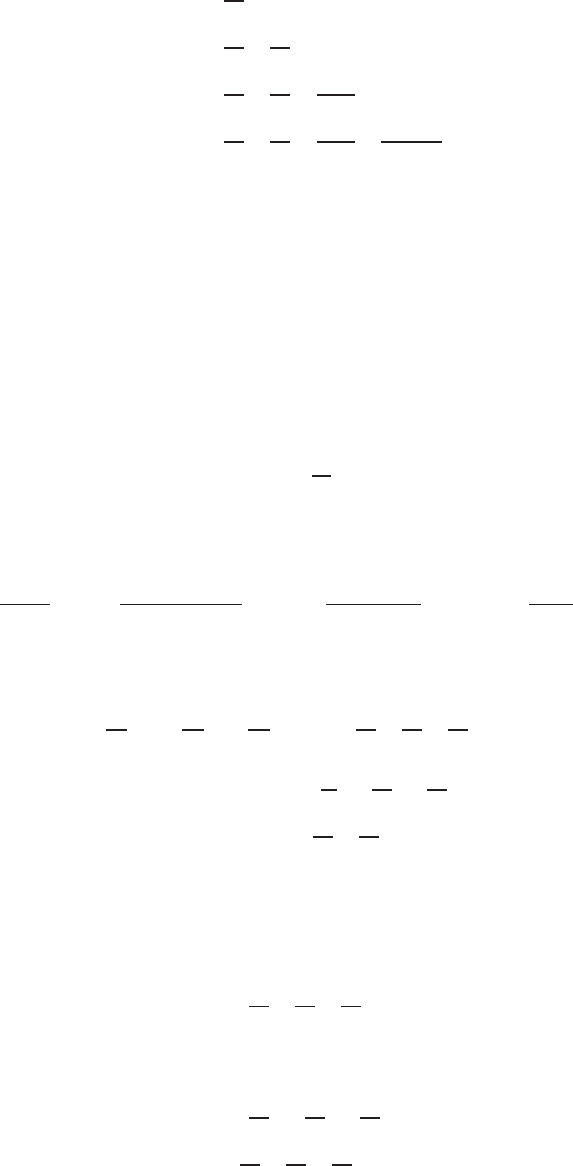
902 Chapter Nine /SOLUTIONS
(c) We have
S0(x) = 1
S1(x) = 1 −x2
4
S2(x) = 1 −x2
4+x4
64
S3(x) = 1 −x2
4+x4
64 −x6
2304
S4(x) = 1 −x2
4+x4
64 −x6
2304 +x8
147,456 .
(d) The value of J(1) can be approximated using partial sums. Substituting x= 1 into the partial sum polynomials, we
have
S0(1) = 1
S1(1) = 0.75
S2(1) = 0.765625
S3(1) = 0.765191
S4(1) = 0.765198.
We estimate that J(1) ≈0.765. Theorem 9.9 can be used to bound the error.
(e) We see from the series that J(x)is an even function, so J(−1) = J(1). Thus, J(−1) ≈0.765.
46. (a) We have
f(x) = 1 + x+x2
2+···,
so
f(0) = 1 + 0 + 0 + ···= 1.
(b) To find the domain of f, we find the interval of convergence.
lim
n→∞ |an+1|
|an|= lim
n→∞ |xn+1/(n+ 1)!|
|xn/n!|= lim
n→∞ |x|n+1n!
|x|n(n+ 1)! =|x|lim
n→∞
1
n+ 1 = 0.
Thus the series converges for all x, so the domain of fis all real numbers.
(c) Differentiating term-by-term gives
f′(x) = d
dx ∞
X
n=0
xn
n!!=d
dx 1 + x+x2
2! +x3
3! +x4
4! +···
= 0 + 1 + 2 x
2! + 3 x2
3! + 4 x3
4! +···
= 1 + x+x2
2! +x3
3! +···.
Thus, the series for fand f′are the same, so
f(x) = f′(x).
(d) We guess f(x) = ex.
47. (a) Since only odd powers are involved in the series for g(x),
g(x) = x−x3
3! +x5
5! −x7
7! +···,
we see that g(x)is odd. Substituting x= 0 gives g(0) = 0.
(b) Differentiating term by term gives
g′(x) = 1 −3x2
3! + 5 x4
5! −7x6
7! +···
= 1 −x2
2! +x4
4! −x6
6! +···.
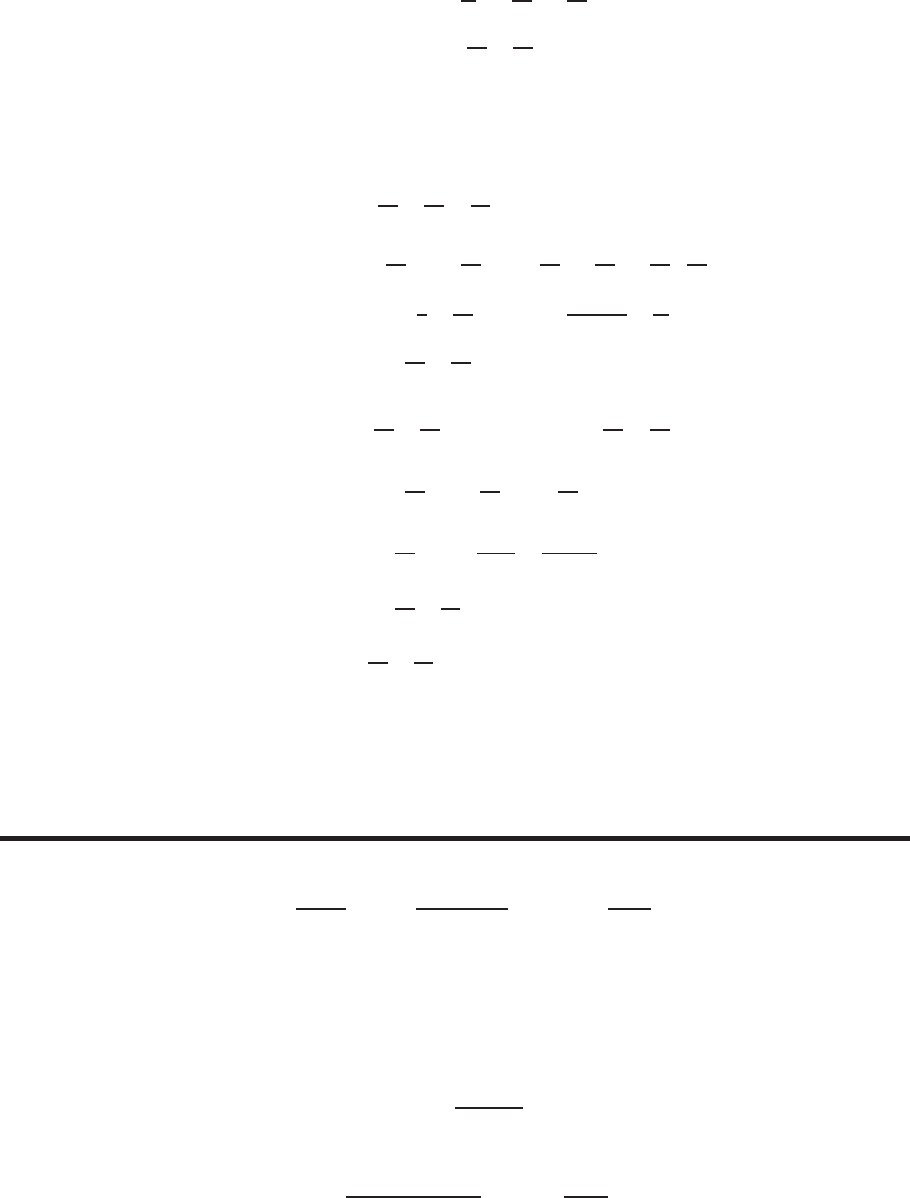
9.5 SOLUTIONS 903
g′′(x) = 0 −2x
2! + 4 x3
4! −6x5
6! +···
=−x+x3
3! −x5
5! +···.
So we see g′′(x) = −g(x).
(c) We guess g(x) = sin xsince then g′(x) = cos xand g′′(x) = −sin x=g(x). We check g(0) = 0 = sin 0 and
g′(0) = 1 = cos 0.
48. (a) We have
(p(x))2=1−x2
2! +x4
4! −x6
6! +···2
=1−2·x2
2+−x2
2! 2
+ 2 x4
4! −2x6
6! −2x2
2! ·x4
4! ···
= 1 −x2+1
4+1
12 x4−x61
3·5·4! +1
4! ···
=1−x2+x4
3−2
45 x6···.
(q(x))2=x−x3
3! +x5
5! − ···2
=x21−x2
3! +x4
5! − ···2
=x2 1−2x2
3! +−x2
3! 2
+ 2 x4
5! ···!
=x21−x2
3+x41
(3!)2+1
5·4·3···
=x21−x2
3+2
45 x4···
=x2−x4
3+2
45 x6···.
Thus, up to terms in x6, we have
(p(x))2+ (q(x))2= 1.
(b) The result of part (a) suggests that p(x)and q(x)could be the sine and cosine. Since p(x)is even and q(x)is odd,
we guess that p(x) = cos xand q(x) = sin x.
Strengthen Your Understanding
49. To find the radius of convergence, we calculate
lim
n→∞ |an+1|
|an|= lim
n→∞
Cn+1|x|n+1
Cn|x|n=|x|lim
n→∞
Cn+1
Cn= 0.
Thus, the radius of convergence is ∞, not 0.
50. The series has an interval of convergence centered at x= 0. Since the series diverges at x= 2, the radius of convergence
is 2 or less. This means that the series diverges for all points at a distance of more than 2 from the origin. Thus, the series
cannot converge at x= 3.
51. In order to get a power series that does not converge at x= 0, we need to construct a power series about a point other
than x= 0. We’ll use a= 2, and the series ∞
X
n=0
(x−2)n
n.
If we let x= 0 and use the ratio test to determine the convergence or divergence of the series, we get
lim
n→∞
(−2)n+1/(n+ 1)
(−2)n/n = lim
n→∞ −2n
n+ 1 = 2.
Since the limit is greater than 1, the series diverges at x= 0 by the ratio test.

904 Chapter Nine /SOLUTIONS
52. The series
∞
X
n=1
n!(x−5)nconverges at x= 5. The ratio test shows that the series diverges for any other value of x, since
lim
n→∞
(n+1)!(x−5)n+1
n!(x−5)n=|x−5|lim
n→∞(n+ 1) >1
for x6= 5.
53. The series with Pxn/n2satisfies this condition. The limit
lim
n→∞ |an+1|
|an|= lim
n→∞ |x|n+1/(n+ 1)2
|x|n/n2=|x|lim
n→∞
n2
(n+ 1)2=|x|.
Thus, the radius of convergence is 1.
At the endpoints, P|xn/n2|=P1/n2, which is a convergent p-series. Thus, the series is absolutely convergent
at the endpoints x=±1.
54. False. Writing out terms, we have
(x−1) + (x−2)2+ (x−3)3+···.
A power series is a sum of powers of (x−a)for constant a. In this case, the value of achanges from term to term, so it
is not a power series.
55. True. This power series has an interval of convergence about x= 0. If the power series converges for x= 2, the radius
of convergence is 2 or more. Thus, x= 1 is well within the interval of convergence, so the series converges at x= 1.
56. False. This power series has an interval of convergence about x= 0. Knowing the power series converges for x= 1 does
not tell us whether the series converges for x= 2. Since the series converges at x= 1, we know the radius of convergence
is at least 1. However, we do not know whether the interval of convergence extends as far as x= 2, so we cannot say
whether the series converges at x= 2.
For example, Xxn
2nconverges for x= 1 (it is a geometric series with ratio of 1/2), but does not converge for
x= 2 (the terms do not go to 0).
Since this statement is not true for all Cn, the statement is false.
57. True. This power series has an interval of convergence centered on x= 0. If the power series does not converge for x= 1,
then the radius of convergence is less than or equal to 1. Thus, x= 2 lies outside the interval of convergence, so the series
does not converge there.
58. True. The radius of convergence, R, is given by lim
n→∞ |Cn+1|/|Cn|= 1/R, if this limit exists, and since these series have
the same coefficients, Cn, the radii of convergence are the same.
59. False. Two series can have the same radius of convergence without having the same coefficients. For example, Pxnand
Pnxnboth have radius of convergence of 1:
lim
n→∞
Cn+1
Cn
= lim
n→∞
1
1= 1 and lim
n→∞
Bn+1
Bn
= lim
n→∞
n+ 1
n= 1.
60. False. There are power series, such as Pxn/n, which converge at one endpoint, −1, but not at the other, 1.
61. True. The power series PCn(x−a)nconverges at x=a.
62. True. Since the power series converges at x= 10, the radius of convergence is at least 10. Thus, x=−9must be within
the interval of convergence.
63. False. If PCnxnconverges at x= 10, the radius of convergence is at least 10. However, if the radius of convergence
were exactly 10, then x= 10 is the endpoint of the interval of convergence and convergence there does not guarantee
convergence at the other endpoint.
64. True. Intervals of convergence can be of any length and centered at any point and can include one endpoint and not the
other.
65. False. The interval of convergence of PCnxnis centered at the origin.
66. True. The interval of convergence is centered on x=a, so a= (−11 + 1)/2 = −5.
67. (d). Since the series is centered at x= 0 and diverges at x= 7, the radius of convergence is R≤7. The series converges
at x=−3, so R≥3. Since | − 9|= 9 > R, the series diverges at x=−9.

SOLUTIONS to Review Problems for Chapter Nine 905
Solutions for Chapter 9 Review
Exercises
1. 3 + 3
2+3
4+3
8···+3
210 = 3 1 + 1
2+···+1
210 =31−1
211
1−1
2
=3211 −1
210
2. We have
Sum =−2 + 1 −1
2+1
4−1
8+1
16 − ···
=−2 + (−2) −1
2+ (−2) −1
22
+ (−2) −1
23
+···
=−2
1 + 1/2=−4
3.
3. This is the sum of a finite geometric series with a= 125, n = 21, x = 0.8:
S21 = 125
|{z}
a
+125(0.8)
| {z }
ax
+ 125(0.8)2
| {z }
ax2
+··· + 125(0.8)20
| {z }
axn−1
=125 1−0.821
1−0.8
| {z }
a(1−xn)
1−x
= 619.235.
4. This is a finite geometric series with k−2terms in it, so n=k−2.The initial term is a= (0.5)3= 0.125 and the
constant ratio is x= 0.5.Using the formula for the sum of a finite geometric series, we get
Sum =a(1 −xn)
1−x=0.125(1 −(0.5)k−2)
1−0.5= 0.25(1 −(0.5)k−2).
5. If b= 1, then the sum is 6. If b6= 1, we use the formula for the sum of a finite geometric series. We can write the series as
b5+b5·b+b5·b2+b5·b3+b5·b4+b5·b5.
This is a six-term geometric series (n= 6) with initial term a=b5and constant ratio x=b:
Sum =a(1 −xn)
1−x=b5(1 −b6)
1−b.
6. Using the formula for the sum of an infinite geometric series,
∞
X
n=41
3n
=1
34
+1
35
+··· =1
341 + 1
3+1
32
+···=(1
3)4
1−1
3
=1
54
7. Using the formula for the sum of a finite geometric series,
20
X
n=41
3n
=1
34
+1
35
+···+1
320
=1
341 + 1
3+1
32
+···1
316=(1/3)4(1 −(1/3)17)
1−(1/3) =317 −1
2·320 .
8.
∞
X
n=0
3n+ 5
4n=∞
X
n=0 3
4n
+∞
X
n=0
5
4n, a sum of two geometric series.
We have
∞
X
n=03
4n
=1
1−3/4= 4 and
∞
X
n=0
5
4n=5
1−1/4=20
3,so
∞
X
n=0
3n+ 5
4n= 4 + 20
3=32
3
.

906 Chapter Nine /SOLUTIONS
9. We have
S1= 36.
S2= 36 + 36 1
3= 48.
S3= 36 + 36 1
3+ 36 1
32
= 52.
S4= 36 + 36 1
3+ 36 1
32
+ 36 1
33
= 53.333.
Here we have a= 36 and x= 1/3, so
Sn=a(1 −xn)
1−x=36(1 −(1/3)n)
1−1/3.
As n→ ∞, we see that Sn→36/(2/3) = 54.
10. We have
S1= 1280.
S2= 1280 + 1280 −3
4= 320.
S3= 1280 + 1280 −3
4+ 1280 −3
42
= 1040.
S4= 1280 + 1280 −3
4+ 1280 −3
42
+1280 −3
43
=500.
Here we have a= 1280 and x=−3/4, so
Sn=a(1 −xn)
1−x=1280(1 −(−3/4)n)
1 + 3/4.
As n→ ∞, we see that Sn→1280/(7/4) = 731.429.
11. We have
S1=−810.
S2=−810 −810 −2
3=−270.
S3=−810 −810 −2
3−810 −2
32
=−630.
S4=−810 −810 −2
3−810 −2
32
−810 −2
33
=−390.
Here we have a=−810 and x=−2/3, so
Sn=a(1 −xn)
1−x=−810(1 −(−2/3)n)
1 + 2/3.
As n→ ∞, we see that Sn→ −810/(5/3) = −486.
12. We have
S1= 2.
S2= 2 + 2(3z).
S3= 2 + 2(3z) + 2(3z)2.
S4= 2 + 2(3z) + 2(3z)2+ 2(3z)3.
Here we have a= 2 and x= 3z, so
Sn=a(1 −xn)
1−x=2(1 −(3z)n)
1−3z.
As n→ ∞, we see that (3z)n→0if |3z|<1but diverges if |3z| ≥ 1. Thus,
Sn→2
1−3zif |z|<1/3,but diverges otherwise.
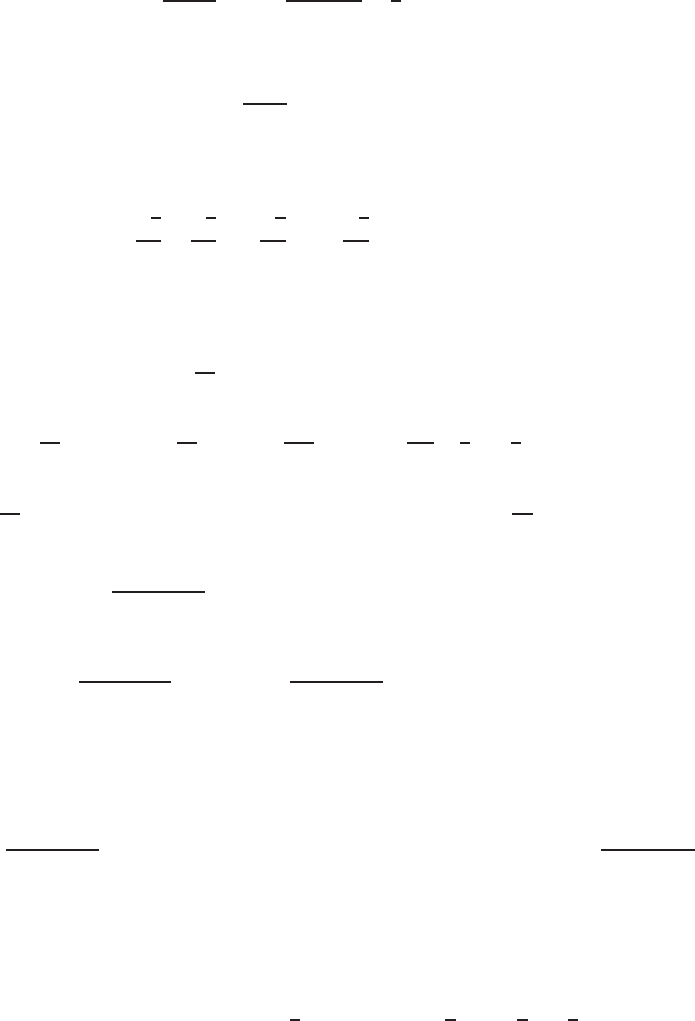
SOLUTIONS to Review Problems for Chapter Nine 907
13. As nincreases, the term 4nis much larger than 3 and 7nis much larger than 5. Thus dividing the numerator and
denominator by nand using the fact that lim
n→∞ 1/n = 0, we have
lim
n→∞
3 + 4n
5 + 7n= lim
n→∞
(3/n) + 4
(5/n) + 7 =4
7.
Thus, the sequence converges to 4/7.
14. We have:
lim
n→∞ n+ 1
n= 1.
The terms of the sequence do not approach 0, and oscillate between values that are getting closer to +1 and −1. Thus the
sequence diverges.
15. The first eight terms of the sequence are:
√2
2,1,√2
2,0,−√2
2,−1,−√2
2,0.
The sequence then repeats this pattern, so it diverges.
16. Since the exponential function 2ndominates the power function n3as n→ ∞, the series diverges.
17. We use the integral test with f(x) = 1/x3to determine whether this series converges or diverges. To do so we determine
whether the corresponding improper integral Z∞
1
1
x3dx converges or diverges:
Z∞
1
1
x3dx = lim
b→∞ Zb
1
1
x3dx = lim
b→∞ −1
2x2
b
1
= lim
b→∞ −1
2b2+1
2=1
2.
Since the integral Z∞
1
1
x3dx converges, we conclude from the integral test that the series
∞
X
n=1
1
n3converges.
18. We use the integral test to determine whether this series converges or diverges. To do so we determine whether the
corresponding improper integral Z∞
1
3x2+ 2x
x3+x2+ 1 dx converges or diverges. The integral can be calculated using the
substitution w=x3+x2+ 1,dw = (3x2+ 2x)dx.
Z∞
1
3x2+2x
x3+x2+ 1 dx = lim
b→∞ Zb
1
3x2+ 2x
x3+x2+ 1 dx
= lim
b→∞ ln |x3+x2+ 1|
b
1
= lim
b→∞ ln |b3+b2+ 1| − ln 3=∞.
Since the integral Z∞
1
3x2+2x
x3+x2+ 1 dx diverges, we conclude from the integral test that the series
∞
X
n=1
3n2+ 2n
n3+n2+ 1
diverges.
19. We use the integral test to determine whether this series converges or diverges. We determine whether the corresponding
improper integral Z∞
0
xe−x2dx converges or diverges:
Z∞
0
xe−x2dx = lim
b→∞ Zb
0
xe−x2dx = lim
b→∞ −1
2e−x2
b
0
= lim
b→∞ −1
2e−b2+1
2=1
2.
Since the integral Z∞
0
xe−x2dx converges, we conclude from the integral test that the series ∞
X
n=0
ne−n2converges.
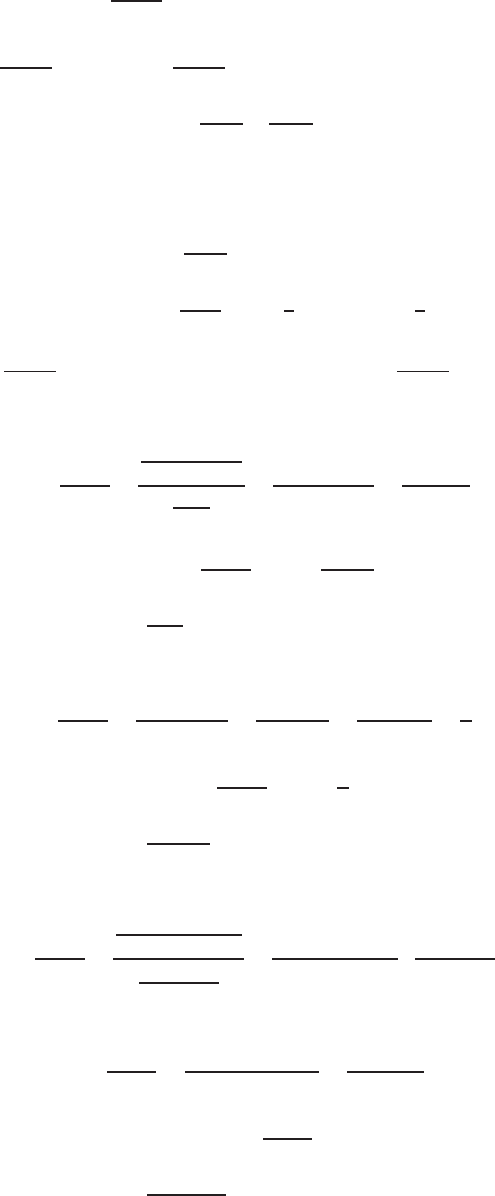
908 Chapter Nine /SOLUTIONS
20. We use the integral test to determine whether this series converges or diverges. To do so we determine whether the
corresponding improper integral Z∞
2
2
x2−1dx converges or diverges:
Z∞
2
2
x2−1dx = lim
b→∞ Zb
2
2
x2−1dx
= lim
b→∞ Zb
21
x−1−1
x+ 1 dx(Using partial fractions)
= lim
b→∞ ln |x−1|−ln |x+ 1|
b
2!
= lim
b→∞ ln
x−1
x+ 1
b
2!
= lim
b→∞ln
b−1
b+ 1 −ln 1
3= ln 1 −ln 1
3= ln 3.
Since the integral Z∞
2
2
x2−1dx converges, we conclude that the series
∞
X
n=2
2
n2−1converges.
21. Since an= 1/(2nn!), replacing nby n+ 1 gives an+1 = 1/(2n+1(n+ 1)!). Thus
|an+1|
|an|=
1
2n+1(n+ 1)!
1
2nn!
=2nn!
2n+1(n+ 1)! =1
2(n+ 1) ,
so
L= lim
n→∞ |an+1|
|an|= lim
n→∞
1
2n+ 2 = 0.
Since L < 1, the ratio test tells us that ∞
X
n=1
1
2nn!converges.
22. Since an= (n−1)!/5n, replacing nby n+ 1 gives an+1 =n!/5n+1.Thus,
|an+1|
|an|=n!/5n+1
(n−1)!/5n=n!
5(n−1)! =n(n−1)!
5(n−1)! =n
5,
so
L= lim
n→∞ |an+1|
|an|= lim
n→∞
n
5=∞.
Since L > 1, the ratio test tells us that
∞
X
n=1
(n−1)!
5ndiverges.
23. Since an= (2n)!/(n!(n+ 1)!), replacing nby n+ 1 gives an+1 = (2n+ 2)!/((n+ 1)!(n+ 2)!). Thus,
|an+1|
|an|=
(2n+ 2)!
(n+ 1)!(n+ 2)!
(2n)!
n!(n+ 1)!
=(2n+ 2)!
(n+ 1)!(n+ 2)! ·n!(n+ 1)!
(2n)! .
However, since (n+ 2)! = (n+ 2)(n+ 1)n!and (2n+ 2)! = (2n+ 2)(2n+ 1)(2n)!, we have
|an+1|
|an|=(2n+ 2)(2n+ 1)
(n+ 2)(n+ 1) =2(2n+ 1)
n+ 2 ,
so
L= lim
n→∞ |an+1|
|an|= 4.
Since L > 1, the ratio test tells us that
∞
X
n=1
(2n)!
n!(n+ 1)! diverges.
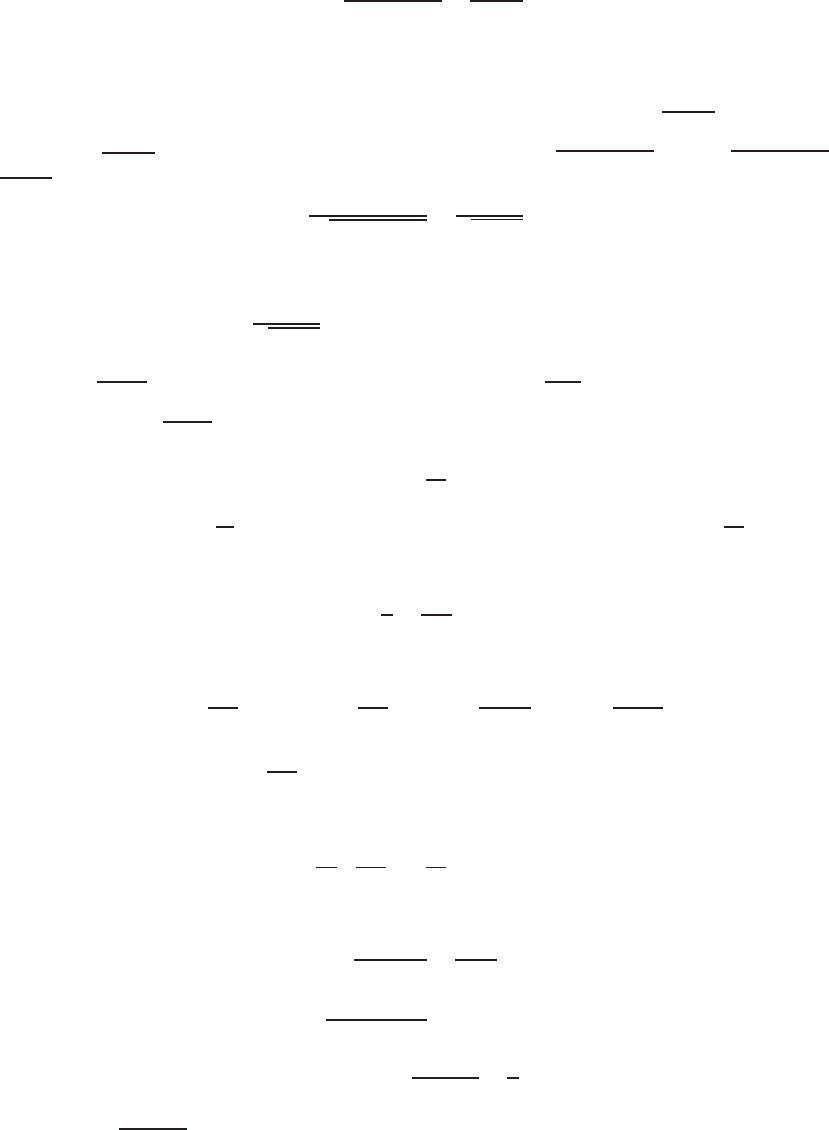
SOLUTIONS to Review Problems for Chapter Nine 909
24. Let an= 1/(n2+ 1). Then replacing nby n+ 1 gives an+1 = 1/((n+ 1)2+ 1). Since (n+ 1)2+ 1 > n2+ 1, we have
0<1
(n+ 1)2+ 1 <1
n2+ 1 ,
so
0< an+1 < an.
We also have limn→∞ an= 0, therefore, the alternating series test tells us that the series
∞
X
n=1
(−1)n
n2+ 1 converges.
25. Let an= 1/√n2+ 1. Then replacing nby n+ 1 we have an+1 = 1/p(n+ 1)2+ 1. Since p(n+ 1)2+ 1 >
√n2+ 1, we have 1
p(n+ 1)2+ 1 <1
√n2+ 1 ,
so
0< an+1 < an.
In addition, limn→∞ an= 0 so
∞
X
n=0
(−1)n
√n2+ 1 converges by the alternating series test.
26. The series X(−1)n
n1/2converges by the alternating series test. However X1
n1/2diverges because it is a p-series with
p= 1/2≤1. Thus X(−1)n
n1/2is conditionally convergent.
27. Since
lim
n→∞ 1 + 1
n2= 1,
the nth term an= (−1)n1 + 1
n2does not tend to zero as n→ ∞. Thus, the series X(−1)n1 + 1
n2is divergent.
28. We first check absolute convergence by deciding whether Pln n/n converges. Since ln(n)>1for all n > 2, we
compare
1
n<ln n
n.
The harmonic series P1/n diverges, so Pln n/n diverges. Alternatively, we can use the integral test. Since
Z∞
1
lnx
xdx = lim
b→∞ Zb
1
ln x
xdx = lim
b→∞
(ln x)2
2
b
1
=lim
b→∞
(ln b)2
2,
and since this limit does not exist, Xln n
ndiverges.
We now check conditional convergence. The original series is alternating, so we check whether an+1 < an. Consider
an=f(n), where f(x) = ln n/n. Since
d
dx ln x
x=1
x2(1 −ln x)
is negative for x > e, we know that anis decreasing for n > e. Thus for n≥3,
an+1 =ln(n+ 1)
n+ 1 <ln(n)
n=an.
Since ln n/n →0as n→ ∞, we see that X(−1)n−1ln n
nis conditionally convergent.
29. Since
lim
n→∞ an= lim
n→∞
1
arctan n=2
π6= 0
we know that X(−1)n−1
arctan ndiverges by Property 3 of Theorem 9.2.

910 Chapter Nine /SOLUTIONS
30. Let an=n2/(3n2+ 4). Since 3n2+ 4 >3n2, we have n2
3n2+ 4 <1
3, so
0< an<1
3n
.
The geometric series ∞
X
n=11
3n
converges, so the comparison test tells us that the series ∞
X
n=1 n2
3n2+ 4 n
also con-
verges.
31. Let an= 1/(nsin2n). Since 0<sin2n < 1, for any positive integer n, we have nsin2n < n, so 1
nsin2n>1
n, thus
an>1
n.
The harmonic series
∞
X
n=1
1
ndiverges, so the comparison test tells us that the series
∞
X
n=1
1
nsin2nalso diverges.
32. The nth term an=√n−1/(n2+ 3) behaves like √n/n2= 1/n3/2for large n, so we take bn= 1/n3/2. We have
lim
n→∞
an
bn
= lim
n→∞
√n−1/(n2+ 3)
1/n3/2= lim
n→∞
n3/2√n−1
n2+ 3 = lim
n→∞
n2p1−1/n
n2(1 + 3/n2)= 1.
The limit comparison test applies with c= 1. The p-series P1/n3/2converges because p= 3/2>1. Therefore
P√n−1/(n2+ 3) also converges.
33. The nth term an= (n3−2n2+n+ 1)/(n5−2) behaves like n3/n5= 1/n2for large n, so we take bn= 1/n2. We
have
lim
n→∞
an
bn
= lim
n→∞
(n3−2n2+n+ 1)/(n5−2)
1/n2= lim
n→∞
n5−2n4+n3+n2
n5−2= 1.
The limit comparison test applies with c= 1. The p-series P1/n2converges because p= 2 >1. Therefore the series
Pn3−2n2+n+ 1/n5−2also converges.
34. The nth term is an= sin(1/n2). When nis large, 1/n2is near zero, so sin(1/n2)is near 1/n2. We see that sin(1/n2)
behaves like 1/n2for large n, so we take bn= 1/n2. We have
lim
n→∞
an
bn
= lim
n→∞
sin(1/n2)
1/n2
= lim
x→0
sin x
x
= 1.
The limit comparison test applies with c= 1. The p-series P1/n2converges because p= 2 >1. Therefore Psin(1/n2)
also converges.
35. The nth term an= 1/(√n3−1) behaves like 1/√n3= 1/n3/2for large n, so we take bn= 1/n3/2. We have
lim
n→∞
an
bn
= lim
n→∞
1/√n3−1
1/n3/2= lim
n→∞
n3/2
√n3−1= lim
n→∞
n3/2
n3/2p1−1/n3= lim
n→∞
1
p1−1/n3=1
√1−0= 1.
The limit comparison test applies with c= 1. The p-series P1/n3/2converges because p= 3/2>1. Therefore
P1/√n3−1also converges.
36. Since f(x) = 1/(x+ 1) is continuous, positive and decreasing, we apply the integral test, and we obtain
Z∞
1
1
x+ 1 dx = lim
b→∞ Zb
1
1
1 + xdx = lim
b→∞(ln(b+ 1) −ln 2) = ∞.
Since this improper integral diverges, the series
∞
X
n=1
1
n+ 1 also diverges. We can also observe the series is the harmonic
series, with the first term missing, and hence diverges by Property 2 of Theorem 9.2.
37. This is a p-series with p > 1, so it converges.
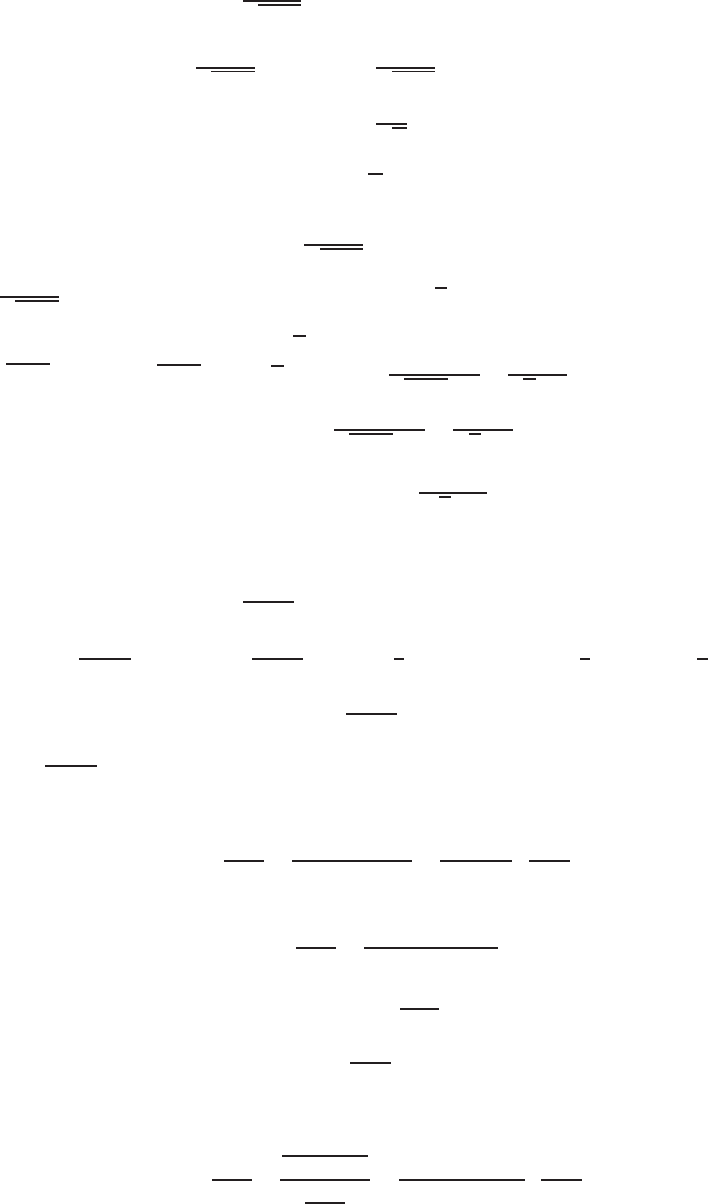
SOLUTIONS to Review Problems for Chapter Nine 911
38. We use the integral test to determine whether this series converges or diverges. To do so we determine whether the
corresponding improper integral Z∞
3
2
√x−2dx converges or diverges:
Z∞
3
2
√x−2dx = lim
b→∞ Zb
3
2
√x−2dx
= lim
b→∞ Zb
1
2
√wdw (Substitute w=x−2.)
= lim
b→∞ 4√w
b
1
=∞.
Since the limit does not exist, the integral Z∞
3
2
√x−2dx diverges, and we conclude from the integral test that the series
∞
X
n=3
2
√n−2diverges. The limit comparison test with bn= 1/√ncan also be used.
39. This is an alternating series. Let an= 1/(√n+ 1). Then limn→∞ an= 0. Now replace nby n+ 1 to give an+1 =
1/(√n+ 1 + 1). Since √n+ 1 + 1 >√n+ 1, we have 1
√n+ 1 + 1 <1
√n+ 1 , so
0< an+1 =1
√n+ 1 + 1 <1
√n+ 1 =an.
Therefore, the alternating series test tells us that the series
∞
X
n=1
(−1)n−1
√n+ 1 converges.
40. Writing an=n2/(n2+ 1), we have limn→∞ an= 1 so the series diverges by Property 3 of Theorem 9.2.
41. We use the integral test to determine whether this series converges or diverges. To do so we determine whether the
corresponding improper integral Z∞
1
x2
x3+ 1 dx converges or diverges:
Z∞
1
x2
x3+ 1 dx = lim
b→∞ Zb
1
x2
x3+ 1 dx = lim
b→∞
1
3ln |x3+ 1|
b
1
= lim
b→∞ 1
3ln(b3+ 1) −1
3ln 2.
Since the limit does not exist, the integral Z∞
1
x2
x3+ 1 dx diverges an so we conclude from the integral test that the
series
∞
X
n=1
n2
n3+ 1 diverges. The limit comparison test with bn= 1/n can also be used.
42. We use the ratio test. Since an= 3n/(2n)!, replacing nby n+ 1 gives an+1 = 3n+1/(2n+ 2)!. Thus
an+1
an
=3n+1/(2n+ 2)!
3n/(2n)! =3n+1
(2n+ 2)! ·(2n)!
3n.
Since (2n+ 2)! = (2n+ 2)(2n+ 1)(2n)!, we have
an+1
an
=3
(2n+ 2)(2n+ 1) ,
so
L= lim
n→∞
an+1
an
= 0.
Since L < 1, the ratio test tells us that the series
∞
X
n=1
3n
(2n)! converges.
43. We use the ratio test. Since an= (2n)!/(n!)2, replacing nby n+ 1 gives an+1 = (2n+ 2)!/((n+ 1)!)2. Thus
an+1
an
=
(2n+ 2)!
((n+ 1)!)2
(2n)!
(n!)2
=(2n+ 2)!
(n+ 1)!(n+ 1)! ·n!n!
(2n)! .
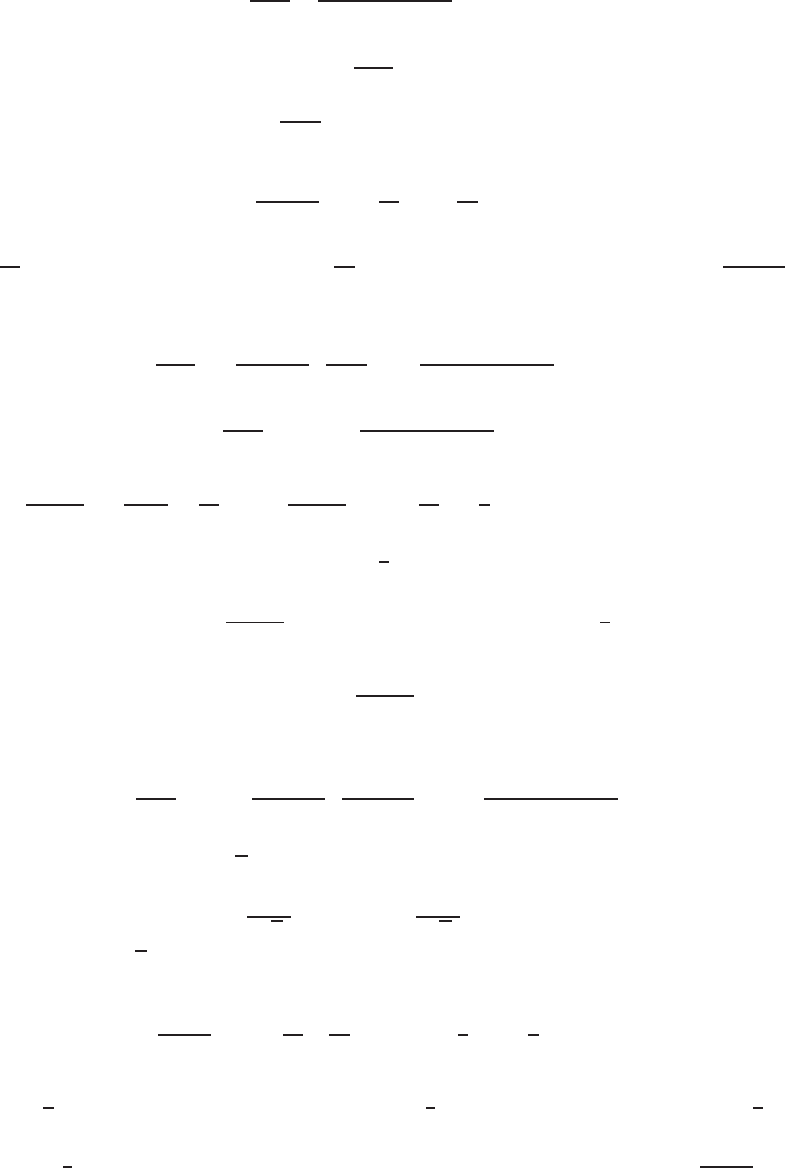
912 Chapter Nine /SOLUTIONS
Since (2n+ 2)! = (2n+ 2)(2n+ 1)(2n)! and (n+ 1)! = (n+ 1)n!, we have
an+1
an
=(2n+ 2)(2n+ 1)
(n+ 1)(n+ 1) ,
therefore
L= lim
n→∞
an+1
an
= 4.
As L > 1the ratio test tells us that the series ∞
X
n=1
(2n)!
(n!)2diverges.
44. The series can be written as ∞
X
n=1
n2+ 2n
n22n=∞
X
n=1
1
2n+∞
X
n=1
1
n2.
Since
∞
X
n=1
1
2nis a convergent geometric series and
∞
X
n=1
1
n2converges as a p-series with p > 1, we see
∞
X
n=1
n2+ 2n
n22n
converges by Theorem 9.2.
45. We use the ratio test:
an+1
an=
32n+2
(2n+ 2)! ·(2n)!
32n= 321
(2n+ 2)(2n+ 1) .
Therefore we have
lim
n→∞
an+1
an= 32lim
n→∞
1
(2n+ 2)(2n+ 1) = 0.
Thus by the ratio test, the series converges.
46. Let an= 2−n(n+ 1)
(n+ 2) =n+ 1
n+ 2 1
2n. Since (n+ 1)
(n+ 2) <1and 1
2n=1
2n
, we have
0< an<1
2n
,
so that we can compare the series
∞
X
n=1
2−n(n+ 1)
(n+ 2) with the convergent geometric series
∞
X
n=1 1
2n
. The comparison test
tells us that ∞
X
n=1
2−n(n+ 1)
(n+ 2)
also converges.
47. We have
L= lim
n→∞
an+1
an= lim
n→∞
2n+1
(2n+ 3)! ·(2n+ 1)!
2n= lim
n→∞
2
(2n+ 3)(2n+ 2) = 0,
so the series converges by the ratio test, since L < 1.
48. Since there is an nin the numerator and a √nin the denominator, the terms in this series are increasing in magnitude. We
have
lim
n→∞
n+ 1
√n(−1)n= lim
n→∞
n+ 1
√n=∞,
so limn→∞(−1)n(n+ 1)/√ndoes not approach zero. Therefore, the series diverges by Property 3of Theorem 9.2.
49. The series can be written as
∞
X
n=0
2 + 3n
5n=∞
X
n=0 2
5n+3n
5n=∞
X
n=0 21
5n
+3
5n.
The series
∞
X
n=01
5n
is a geometric series which converges because |1
5|<1. Likewise, the geometric series
∞
X
n=0 3
5n
converges because |3
5|<1. Since both series converge, Property 1 of Theorem 9.2 tells us that the series ∞
X
n=0
2 + 3n
5nalso
converges.
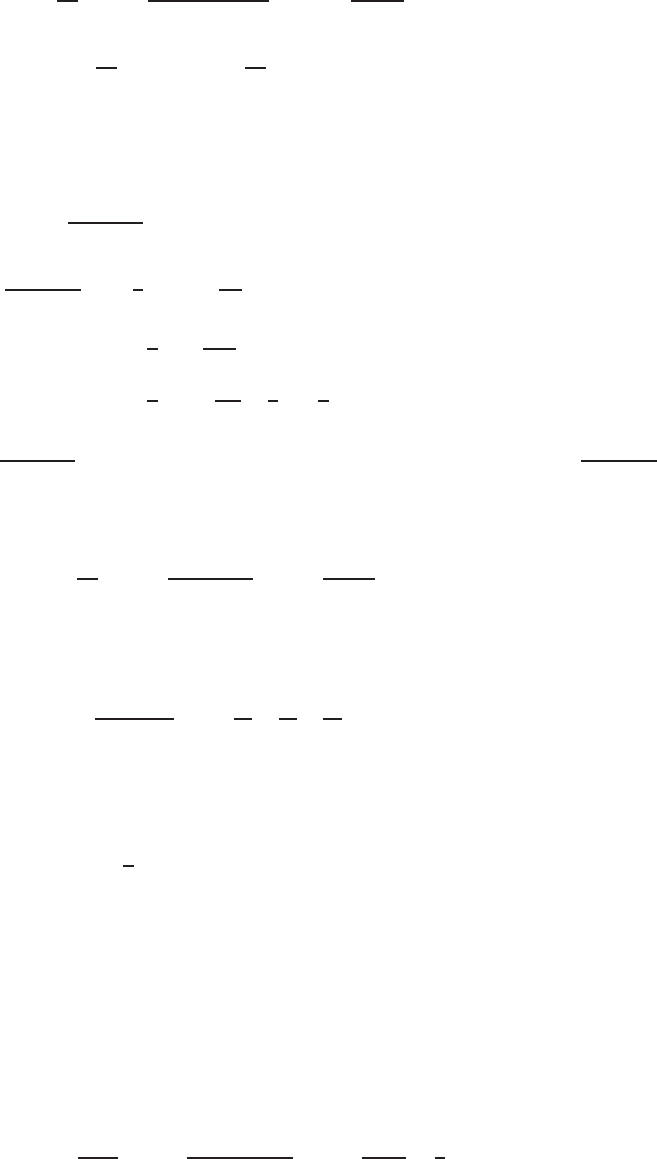
SOLUTIONS to Review Problems for Chapter Nine 913
50. The nth term an= ((1 + 5n)/(4n))nbehaves like (5/4)nfor large n, so we take bn= (5/4)nand use the limit
comparison test. We have
lim
n→∞
an
bn
= lim
n→∞
((1 + 5n)/4n)n
(5/4)n= lim
n→∞ 1 + 5n
5nn
,
so
lim
n→∞
an
bn
= lim
n→∞ 1 + 1
5n5n1/5
=e1/5.
The limit comparison test applies with c=e1/5. The geometric series P(5/4)ndiverges because x= 5/4≥1.
Therefore P((1 + 5n)/(4n))nalso diverges.
51. Writing an= 1/(2 + sin n), we have limn→∞ andoes not exist, so the series diverges by Property 3 of Theorem 9.2.
52. We use the integral test to determine whether this series converges or diverges. To do so we determine whether the
corresponding improper integral Z∞
3
1
(2x−5)3dx converges or diverges:
Z∞
3
1
(2x−5)3dx =1
2lim
b→∞ Zb
1
1
w3dw (Substitute w= 2x−5)
=−1
2lim
b→∞
1
2w2
b
1
=−1
2lim
b→∞ 1
2b2−1
2=1
4.
Since the integral Z∞
3
1
(2x−5)3dx converges, we conclude from the integral test that the series
∞
X
n=3
1
(2n−5)3
converges. The limit comparison test, with bn= 1/n3can also be used.
53. The nth term an= 1/(n3−3) behaves like 1/n3for large n, so we take bn= 1/n3. We have
lim
n→∞
an
bn
= lim
n→∞
1/(n3−3)
1/n3= lim
n→∞
n3
n3−3= 1.
The limit comparison test applies with c= 1. The p-series P1/n3converges because p= 3 >1. Therefore X1/(n3−
3also converges.
54. Note that ∞
X
n=1
sin(nπ/2)
n3= 1 −1
33+1
53−1
73+···
is an alternating series with the absolute values of the terms decreasing to 0. Thus, the series converges by the alternating
series test.
55. Since ln(1 + 1/k) = ln((k+ 1)/k) = ln(k+ 1) −ln k, the nth partial sum of this series is
Sn=
n
X
k=1
ln 1 + 1
k
=
n
X
k=1
ln(k+ 1) −
n
X
k=1
ln k
= (ln 2 + ln 3 + ···+ ln(n+ 1)) −(ln 1 + ln 2 + · ·· + ln n)
= ln(n+ 1) −ln 1
= ln(n+ 1).
Thus, the partial sums, Sn, grow without bound as n→ ∞, so the series diverges by the definition.
56. The ratio test gives
L= lim
n→∞
an+1
an
= lim
n→∞
(n+ 1)/2n+1
n/2n= lim
n→∞
n+ 1
2n=1
2,
so the series converges since L < 1.
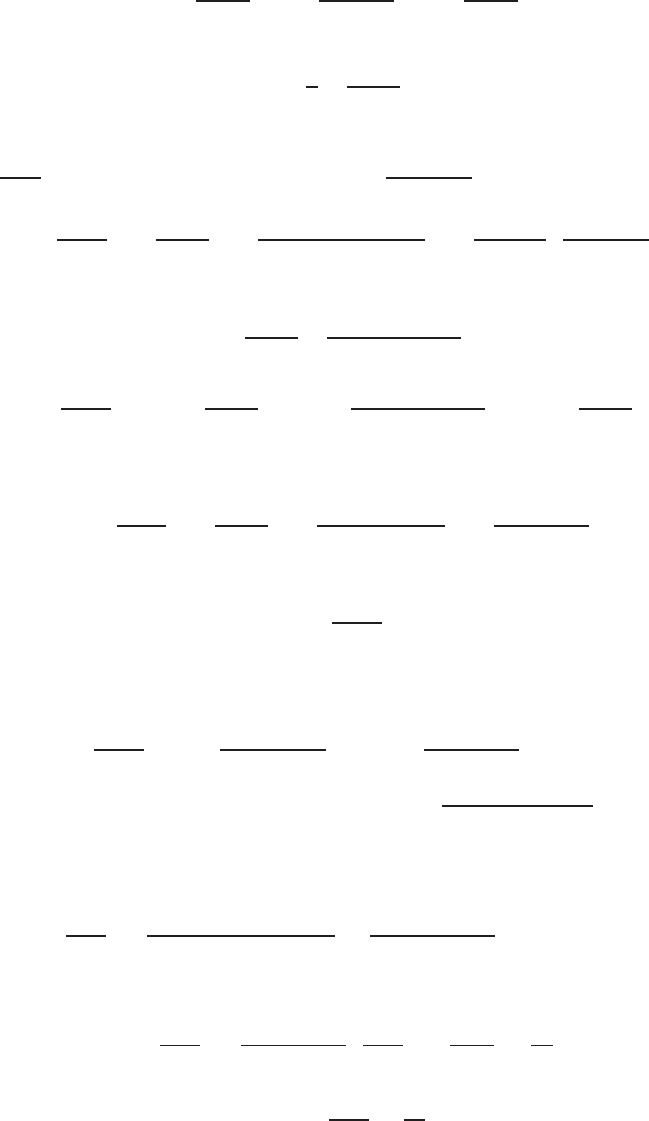
914 Chapter Nine /SOLUTIONS
57. Since ln ngrows much more slowly than n, we suspect that (ln n)2< n for large n. This can be confirmed with
L’Hopital’s rule.
lim
n→∞
(ln n)2
n= lim
n→∞
2(ln n)/n
1= lim
n→∞
2(ln n)
n= 0.
Therefore, for large n, we have (ln n)2/n < 1, and hence for large n,
1
n<1
(ln n)2.
Thus P∞
n=2 1/(ln n)2diverges by comparison with the divergent harmonic series P1/n.
58. Let Cn=(2n)!
(n!)2. Then replacing nby n+ 1, we have Cn+1 =(2n+ 2)!
((n+ 1)!)2. Thus, with an= (2n)!xn/(n!)2, we have
|an+1|
|an|=|x||Cn+1|
|Cn|=|x|(2n+ 2)!/((n+ 1)!)2
(2n)!/(n!)2=|x|(2n+ 2)!
(2n)! ·(n!)2
((n+ 1)!)2.
Since (2n+ 2)! = (2n+ 2)(2n+ 1)(2n)! and (n+ 1)! = (n+ 1)n!we have
|Cn+1|
|Cn|=(2n+ 2)(2n+ 1)
(n+ 1)(n+ 1) ,
so
lim
n→∞ |an+1|
|an|=|x|lim
n→∞ |Cn+1|
|Cn|=|x|lim
n→∞
(2n+ 2)(2n+ 1)
(n+ 1)(n+ 1) =|x|lim
n→∞
4n+ 2
n+ 1 = 4|x|,
so the radius of convergence of this series is R= 1/4.
59. Let Cn= 1/(n! + 1). Then replacing nby n+ 1 gives Cn+1 = 1/((n+ 1)! + 1). Using the ratio test, we have
|an+1|
|an|=|x||Cn+1|
|Cn|=|x|1/((n+ 1)! + 1)
1/(n! + 1) =|x|n! + 1
(n+ 1)! + 1 .
Since n!and (n+ 1)! dominate the constant term 1as n→ ∞ and (n+ 1)! = (n+ 1) ·n!we have
lim
n→∞ |an+1|
|an|= 0.
Thus the radius of convergence is R=∞.
60. To find R, we consider the following limit, where the coefficient of the nth term is given by Cn=n2.
lim
n→∞ |an+1|
|an|= lim
n→∞
(n+ 1)2xn+1
n2xn= lim
n→∞ |x|n2+ 2n+ 1
n2
=|x|lim
n→∞ 1 + (2/n) + (1/n2)
1=|x|.
Thus, the radius of convergence is R= 1.
61. Here the coefficient of the nth term is Cn=n/(2n+ 1).Now we have
an+1
an=
((n+1)/(2n+ 3))xn+1
(n/(2n+ 1))xn=(n+1)(2n+ 1)
n(2n+ 3) |x| → |x|as n→ ∞.
Thus, by the ratio test, the radius of convergence is R= 1.
62. We use the ratio test:
an+1
an=
xn+1
3n+1(n+ 1)2·3nn2
xn=n
n+ 1 2
·|x|
3.
Since n/(n+ 1) →1as n→ ∞, we have
lim
n→∞
an+1
an=|x|
3.
We have |x|/3<1when |x|<3. The radius of convergence is 3 and the series converges for −3< x < 3.
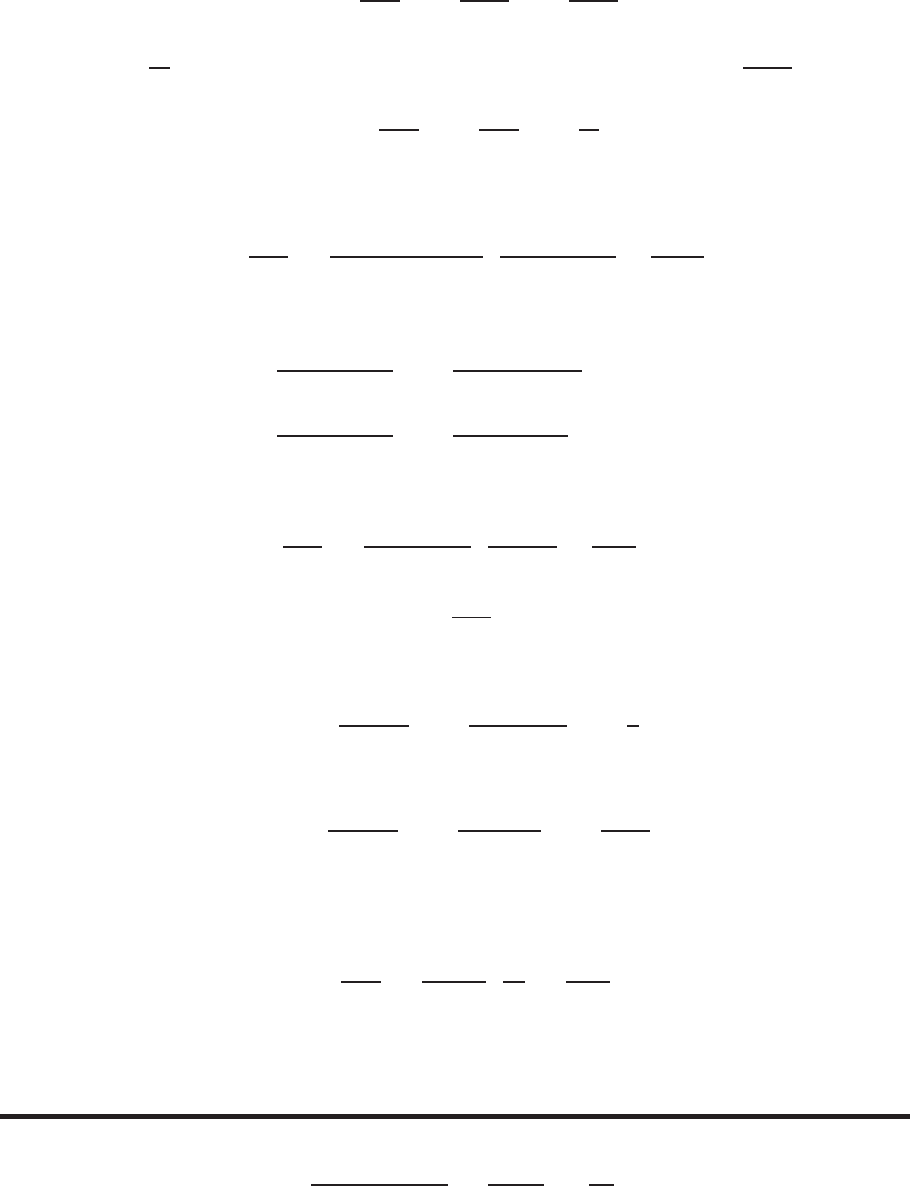
SOLUTIONS to Review Problems for Chapter Nine 915
We check the endpoints. For x=−3, we have
∞
X
n=1
xn
3nn2=∞
X
n=1
(−3)n
3nn2=∞
X
n=1
(−1)n
n2.
We know X1
n2is a p-series with p= 2 so it converges. Therefore the alternating series X(−1)n
n2also converges.
For x= 3, we have ∞
X
n=1
xn
3nn2=∞
X
n=1
3n
3nn2=∞
X
n=1
1
n2.
This is a p-series with p= 2 and it converges. The series converges at both its endpoints and the interval of convergence
is −3≤x≤3.
63. We use the ratio test:
an+1
an=
(−1)n+1(x−2)n+1
5n+1 ·5n
(−1)n(x−2)n=|x−2|
5.
Since |x−2|/5<1when |x−2|<5, the radius of convergence is 5 and the series converges for −3< x < 7.
We check the endpoints:
x=−3 : ∞
X
n=0
(−1)n(x−2)n
5n=∞
X
n=0
(−1)n(−3−2)n
5n=∞
X
n=0
1which diverges.
x= 7 : ∞
X
n=0
(−1)n(x−2)n
5n=∞
X
n=0
(−1)n(7 −2)n
5n=∞
X
n=0
(−1)nwhich diverges.
The series diverges at both the endpoints, so the interval of convergence is −3< x < 7.
64. We use the ratio test:
an+1
an=
(−1)n+1xn+1
n+ 1 ·n
(−1)nxn=n
n+ 1 · |x|.
Since n/(n+ 1) →1as n→ ∞, we have
lim
n→∞
an+1
an=|x|.
The series converges for |x|<1. The radius of convergence is 1 and the series converges for −1< x < 1.
We check the endpoints. For x=−1, we have
∞
X
n=1
(−1)nxn
n=∞
X
n=1
(−1)n(−1)n
n=∞
X
n=1
1
n.
This is the harmonic series and diverges. For x= 1, we have
∞
X
n=1
(−1)nxn
n=∞
X
n=1
(−1)n(1)n
n=∞
X
n=1
(−1)n
n.
This is the alternating harmonic series and converges. The series diverges at x=−1and converges at x= 1. Therefore,
interval of convergence is −1< x ≤1.
65. We use the ratio test to find the radius of convergence:
an+1
an=
xn+1
(n+ 1)! ·n!
xn=
x
n+ 1
Since limn→∞ |x|/(n+ 1) = 0 for all x, the radius of convergence is R=∞. There are no endpoints to check. The
interval of convergence is all real numbers −∞ < x < ∞.
Problems
66. We have
s1=(−1)1(2 ·1 + 1)2
22·1−1+ (−1)1+1 =(−1)32
21+ 1 =−9
3=−3

916 Chapter Nine /SOLUTIONS
s2=(−1)2(2 ·2 + 1)2
22·2−1+ (−1)2+1 =52
23+ (−1) =25
7
s3=(−1)3(2 ·3 + 1)2
22·3−1+ (−1)3+1 =(−1)72
25+ 1 =−49
33
s4=(−1)4(2 ·4 + 1)2
22·4−1+ (−1)4+1 =92
27+ (−1) =81
127 ,
so the first four terms are −3,25/7,−49/33,81/127.
67. We see that s1, s2, s3,...forms an arithmetic sequence—that is, the values go up by the same amount, 2, each time. We
conclude that
sn= 2n+ 3.
68. We see that t1, t2, t3,...is a sequence of consecutive odd square numbers. Since t1= 3, we conclude that
tn= (2n+ 1)2.
69. We have
a2=a1+ 2 ·2 = 5 + 4 = 9 because a1= 5
a3=a2+ 2 ·3 = 9 + 6 = 15
a4=a3+ 2 ·4 = 15 + 8 = 23.
70. First, we have
a2=a1+ 2 ·2 = 5 + 4 = 9 because a1= 5
a3=a2+ 2 ·3 = 9 + 6 = 15
a4=a3+ 2 ·4 = 15 + 8 = 23.
Next, we find that
b2=b1+a1= 10 + 5 = 15 because b1= 10
b3=b2+a2= 15 + 9 = 24
b4=b3+a3= 24 + 15 = 39
b5=b4+a4= 39 + 23 = 62.
71. The series can be written as ∞
X
n=1
nr+rn
nrrn=∞
X
n=1
1
rn+∞
X
n=1
1
nr.
If 0< r < 1, both series diverge, but if r > 1both series converge.
If r= 1 the given series becomes
∞
X
n=1
n+ 1
nwhich diverges.
By Theorem 9.2 the given series converges if r > 1.
72. The series converges for |x−2|= 2 and diverges for |x−2|= 4, thus the radius of convergence of the series, R, is at
least 2 but no larger than 4.
(a) False. If x= 7 then |x−2|= 5, so the series diverges.
(b) False. If x= 1 then |x−2|= 1, so the series converges.
(c) True. If x= 0.5then |x−2|= 1.5, so the series converges.
(d) If x= 5 then |x−2|= 3 and it is not possible to determine whether or not the series converges at this point.
(e) False. If x=−3then |x−2|= 5, so the series diverges.
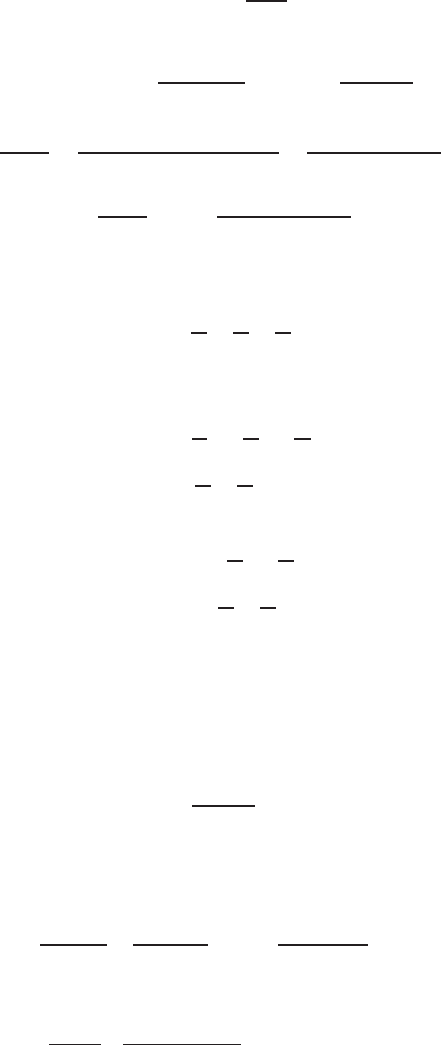
SOLUTIONS to Review Problems for Chapter Nine 917
73. (a) Using an argument similar to Example 7 in Section 9.5, we take
an= (−1)nt2n
(2n)! ,
so, replacing nby n+ 1,
an+1 = (−1)n+1 t2(n+1)
(2(n+ 1))! = (−1)n+1 t2n+2
(2n+ 2)! .
Thus,
|an+1|
|an|=|(−1)n+1t2n+2/(2n+ 2)!|
|(−1)nt2n/(2n)!|=t2
(2n+ 2)(2n+ 1) ,
so
lim
n→∞ |an+1|
|an|= lim
n→∞
t2
(2n+ 2)(2n+ 1) = 0.
The radius of convergence is therefore ∞, so the series converges for all t. Therefore, the domain of his all real
numbers.
(b) Since hinvolves only even powers,
h(t) = 1 −t2
2! +t4
4! −t6
6! +···,
his an even function.
(c) Differentiating term by term, we have
h′(t) = 0 −2t
2! + 4 t3
4! −6t6
6! +···
=−t+t3
3! −t5
5! +···.
h′′(t) = −1 + 3 t2
3! −5t4
5! +···
=−1 + t2
2! −t4
4! +···.
So we see h′′(t) = −h(t).
74. If a payment Min the future has present value P, then
M=P(1 + r)t,
where tis the number of periods in the future and ris the interest rate. Thus
P=M
(1 + r)t.
The monthly interest rate here is 0.09/12 = 0.0075,so the present value of first payment, made at the end of the first
month, is M/(1.0075).The present value of the second payment is M/(1.0075)2.Continuing in this way, the sum of the
present value of all of the payments is
M
(1.0075) +M
(1.0075)2+···+M
(1.0075)240 .
This is a finite geometric series with 240 terms, with sum
M
1.0075 1−1.0075−240
1−1.0075−1= 111.145M.
Setting this equal to the loan amount of 200,000 gives a monthly payment of M= $200,000/111.145 = $1799.45.

918 Chapter Nine /SOLUTIONS
75. In the first year, extraction is 12 million tons. In the second year this falls to 12(1 −0.05) = 12(0.95) million tons, and
in subsequent years the extraction falls by a factor of 0.95.During the next nyears
Total extraction = 12 + 12(0.95) + 12(0.95)2+···12(0.95)n−1,million tons.
This is a geometric series with a= 12 and x= 0.95,so
Total extraction = 12 1−0.95n
1−0.95 .
Since |x|<1, when n→ ∞ Total extraction →12
1−0.95 = 240 million tons.
World reserves of the mineral must exceed 240 million tons if extraction is to continue indefinitely.
76. (a) It is easier to work with the value of the car first and then find the yearly losses. The value of the car goes down by
10% a year. Thus, the value at the end of the first years is v1= 30,000(0.9). The value at the end of the second year
is v2= 30,000(0.9)2. The value at the end of nyears is vn= 30,000(0.9)n. Thus, the losses in the first four years
are
l1= 30,000(0.1)
l2=v1−v2= 30,000(0.9) −30,000(0.9)2= 30,000(0.9)(0.1)
l3=v2−v3= 30,000(0.9)2−30,000(0.9)3= 30,000(0.9)2(0.1)
l4=v3−v4= 30,000(0.9)3−30,000(0.9)4= 30,000(0.9)3(0.1).
Thus,
ln=vn−1−vn= 30,000(0.9)n−1(0.1) = 3000(0.9)n−1.
(b) In the first year, m1= 500; in the second year, m2= 500(1.2); in the third year, m3= 500(1.2)2. Thus
mn= 500(1.2)n−1.
(c) We want to find nsuch that mn≥ln, so
500(1.2)n−1≥3000(0.9)n−1.
We solve
500(1.2)n−1= 3000(0.9)n−1
(1.2)n−1
(0.9)n−1=3000
500
1.2
0.9n−1
=6
(n−1) ln 1.2
0.9= ln 6
n−1 = ln 6
ln(1.2/0.9)
n= 6.228 + 1 = 7.228.
So, maintenance first exceeds losses in year 8. In year 7,
l7= 3000(0.9)6= $1594, m7= 500(1.2)6= $1493.
In year 8,
l8= 3000(0.9)7= $1435, m8= 500(1.2)7= $1792.

SOLUTIONS to Review Problems for Chapter Nine 919
77.
Present value of first coupon =50
1.06
Present value of second coupon =50
(1.06)2,etc.
Total present value =50
1.06 +50
(1.06)2+··· +50
(1.06)10
| {z }
coupons
+1000
(1.06)10
| {z }
principal
=50
1.06 1 + 1
1.06 +··· +1
(1.06)9+1000
(1.06)10
=50
1.06 1−1
1.06 10
1−1
1.06 !+1000
(1.06)10
= 368.004 + 558.395
= $926.40
78.
Present value of first coupon =50
1.04
Present value of second coupon =50
(1.04)2,etc.
Total present value =50
1.04 +50
(1.04)2+··· +50
(1.04)10
| {z }
coupons
+1000
(1.04)10
| {z }
principal
=50
1.04 1 + 1
1.04 +··· +1
(1.04)9+1000
(1.04)10
=50
1.04 1−1
1.04 10
1−1
1.04 !+1000
(1.04)10
= 405.545 + 675.564
= $1081.11
79. (a) The present value is given by the finite series:
Total present value =5
1.04 +5
(1.04)2+···+5
(1.04)100
| {z }
coupons
+100
(1.04)100
| {z }
principal
=5
1.04 1 + 1
1.04 +···+1
(1.04)99 +100
(1.04)100
=5
1.04 1−1
1.04 100
1−1
1.04 !+100
(1.04)100
= $124.50.
(b) The present value is now given by the infinite series
Total present value =5
1.04 +5
(1.04)2+5
(1.04)3+···
=5
1.04 1 + 1
1.04 +1
(1.04)2+···
=5
1.04 1
1−1
1.04 = $125.
Notice how little difference there is between the worth of the bond which pays for 100 years and the one which pays
forever.

920 Chapter Nine /SOLUTIONS
80. The quantity of cephalexin in the body is given by Q(t) = Q0e−kt, where Q0=Q(0) and kis a constant. Since the
half-life is 0.9 hours, 1
2=e−0.9k, k =−1
0.9ln 1
2≈0.8.
(a) After 6 hours
Q=Q0e−k(6) ≈Q0e−0.8(6) =Q0(0.01).
Thus, the percentage of the cephalexin that remains after 6 hours ≈1%.
(b)
Q1= 250
Q2= 250 + 250(0.01)
Q3= 250 + 250(0.01) + 250(0.01)2
Q4= 250 + 250(0.01) + 250(0.01)2+ 250(0.01)3
(c)
Q3=250(1 −(0.01)3)
1−0.01
≈252.5
Q4=250(1 −(0.01)4)
1−0.01
≈252.5
Thus, by the time a patient has taken three cephalexin tablets, the quantity of drug in the body has leveled off to 252.5
mg.
(d) Looking at the answers to part (b) shows that
Qn= 250 + 250(0.01) + 250(0.01)2+··· + 250(0.01)n−1
=250(1 −(0.01)n)
1−0.01 .
(e) In the long run, n→ ∞. So,
Q= lim
n→∞ Qn=250
1−0.01 = 252.5.
81. A person should expect to pay the present value of the bond on the day it is bought.
Present value of first payment =10
1.04
Present value of second payment =10
(1.04)2,etc.
Therefore,
Total present value =10
1.04 +10
(1.04)2+10
(1.04)3+···.
This is a geometric series with a=10
1.04 and x=1
1.04 , so
Total present value =
10
1.04
1−1
1.04
=£250.
82. (a)
Total amount of money deposited = 100 + 92 + 84.64 + ···
= 100 + 100(0.92) + 100(0.92)2+···
=100
1−0.92 = 1250 dollars
(b) Credit multiplier = 1250/100 = 12.50
The 12.50 is the factor by which the bank has increased its deposits, from $100 to $1250.
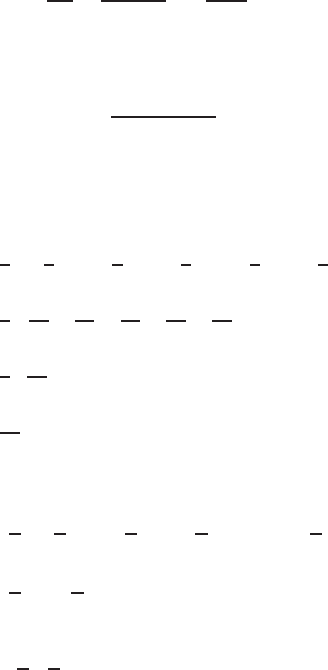
SOLUTIONS to Review Problems for Chapter Nine 921
83. (a) (i) Since the number of bacteria doubles every half hour, the number quadruples every hour. Thus
R1=B0·4
R2=B0·42
.
.
.
Rn=B0·4n.
(ii) Each hour, the number of bacteria is multiplied by a factor a, so
Fn=B0an.
The bacteria doubles in number in 10 hours, so
F10 = 2B0.
Thus,
B0a10 = 2B0
a= 21/10,
so
Fn=B0(21/10)n=B02n/10.
(iii) The ratio is
Yn=Rn
Fn
=B04n
B02n/10 =4
21/10 n
=21.9n.
(b) We want to solve for nmaking Yn= 1,000,000:
21.9n= 1,000,000
n=ln(1,000,000)
ln(21.9)= 10.490.
Thus, in about ten and a half hours, there are a million times as many bacteria in the baby formula kept at room
temperature.
84. (a) We have:
s5=1
51
52
+2
52
+3
52
+4
52
+5
52
=1
51
25 +4
25 +9
25 +16
25 +25
25
=1
5·55
25
=11
25 = 0.44.
(b) From the pattern, we have:
sn=1
n1
n2
+2
n2
+3
n2
+··· +n
n2
=1
n
n
X
i=1 i
n2
.
This can also be written as sn=
n
X
i=1
1
ni
n2
.

922 Chapter Nine /SOLUTIONS
(c) We think of snas a right-hand Riemann sum by writing it as
sn=
n
X
i=1i
n2
|{z}
f(xi)
·1
n
|{z}
∆x
=
n
X
i=1
f(xi) ∆x,
where f(x) = x2,∆x= (1 −0)/n = 1/n, and where x1, x2,...,xnis given by 1/n, 2/n, . . . , 1. We see that
x1, x2,...are evenly-spaced points on the interval from a= 0 to b= 1, separated by gaps of ∆x, as in any standard
right-hand sum. Taking limits, we have:
lim
n→∞ sn= lim
n→∞
n
X
i=1
f(xi) ∆x=Z1
0
f(x)dx =Z1
0
x2dx =1
3x3
1
0
=1
3.
85. This series converges by the alternating series test, so we can use Theorem 9.9. The nth partial sum of the series is given
by
Sn= 1 −1
6+1
120 − ·· · +(−1)n−1
(2n−1)! ,
so the absolute value of the first term omitted is 1/(2n+ 1)!. By Theorem 9.9, we know that the true value of the sum
differs from Snby less than 1/(2n+1)!. Thus, we want to choose nlarge enough so that 1/(2n+1)! ≤0.01. Substituting
n= 2 into the expression 1/(2n+ 1)! yields 1/720 which is less than 0.01, so S2= 1 −(1/6) = 5/6approximates the
sum to within 0.01 of the actual sum.
86. No. If the series
∞
X
n=1
(−1)n−1anconverges then, using Theorem 9.2, part 3, we have lim
n→∞(−1)n−1an= 0, which cannot
happen if lim
n→∞ an6= 0.
87. Let bn= (3/2)n. Then 0≤bn≤2n, and Pbndiverges since it is a geometric series with a common ratio greater than
one. Now, let bn= (1/2)n. Then 0≤bn≤2n, but this time Pbnconverges because it is a geometric series with a
common ratio less than one. Other answers are possible.
88. If P(an+bn)converged, then P(an+bn)−Pan=Pbnwould converge by Theorem 9.2. Since we know that
Pbndoes not converge, we conclude that P(an+bn)diverges.
89. We have 0≤an/n ≤anfor all n≥1. Therefore, since Panconverges, Pan/n converges by the Comparison Test.
90. Since Panconverge, we know that limn→∞ an= 0. Thus limn→∞(1/an)does not exist, and it follows that P(1/an)
diverges by Property 3 of Theorem 9.2.
91. There is not enough information to determine whether or not nanconverges. To see that this is the case, note that if
an= 1/n2, then Pnan=P(1/n), which diverges. However, if an= 1/n3then Pnan=P(1/n2), which
converges.
92. We have an+(an/2) = (3/2)an, so the series P(an+an/2) converges since it is a constant multiple of the convergent
series Pan.
93. Since Panconverges, we know that limn→∞ an= 0. Therefore, we can choose a positive integer Nlarge enough so
that |an| ≤ 1for all n≥N, so we have 0≤a2
n≤anfor all n≥N. Thus, by Property 2 of Theorem 9.2, Pa2
n
converges by comparison with the convergent series Pan.
94. The series ∞
X
n=11
n+1
n=∞
X
n=1
2
n
diverges by Theorem 9.2 and the fact that
∞
X
n=1
1
ndiverges.
The series ∞
X
n=11
n−1
n=∞
X
n=1
0 = 0
converges. But
∞
X
n=1 −1
ndiverges by Theorem 9.2 and the fact that
∞
X
n=1
1
ndiverges.
Thus, if an= 1/n and bn= 1/n, so that Panand Pbnboth diverge, we see that P(an+bn)may diverge.
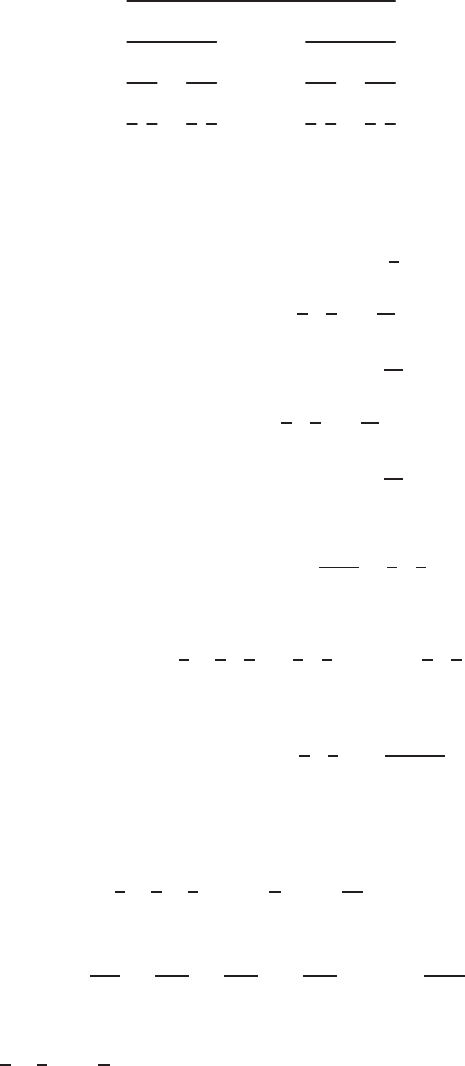
SOLUTIONS to Review Problems for Chapter Nine 923
If, on the other hand, an= 1/n and bn=−1/n, so that Panand Pbnboth diverge, we see that P(an+bn)
may converge.
Therefore, if Panand Pbnboth diverge, we cannot tell whether P(an+bn)converges or diverges. Thus the
statement is true.
95. (a) See Figure 9.9.
C0
C1
C2
C3
Figure 9.9
(b) At the first stage, we remove one segment of length 1/3
At stage 1, length removed =1
3.
At the second stage, we remove 2 = 21segments of length 1
31
3=1
32each.
At stage 2, length removed =21
32.
At the third stage, we remove 4 = 22segments of length 1
31
9=1
33each.
At stage 3, length removed =22
33.
The same reasoning shows that
At stage n, length removed =2n−1
3n=1
32
3n−1
.
To find the length of all segments removed by the nth stage, we add
Total length =1
3+1
32
3+1
32
32
+··· +1
32
3n−1
.
(c) Using part (b), we have an infinite geometric series with a= 1/3and x= 2/3. Therefore
Total length removed =∞
X
i=0
1
32
3i
=1/3
1−2/3= 1.
Notice that even though segments of total length 1 are removed from the initial segment of length 1, there is still an
infinite number of points remaining. The remaining points form a famous fractal, called the Cantor Set.
96. Using a right-hand sum, we have
1
2+1
3+1
4+···+1
n<Zn
1
dx
x= ln n.
If a computer could add a million terms in one second, then it could add
60 sec
min ·60 min
hour ·24 hour
day ·365 days
year ·1million terms
sec
terms per year. Thus,
1 + 1
2+1
3··· +1
n<1 + ln n= 1 + ln(60 ·60 ·24 ·365 ·106)≈32.082 <33.
So the sum after one year is about 32.
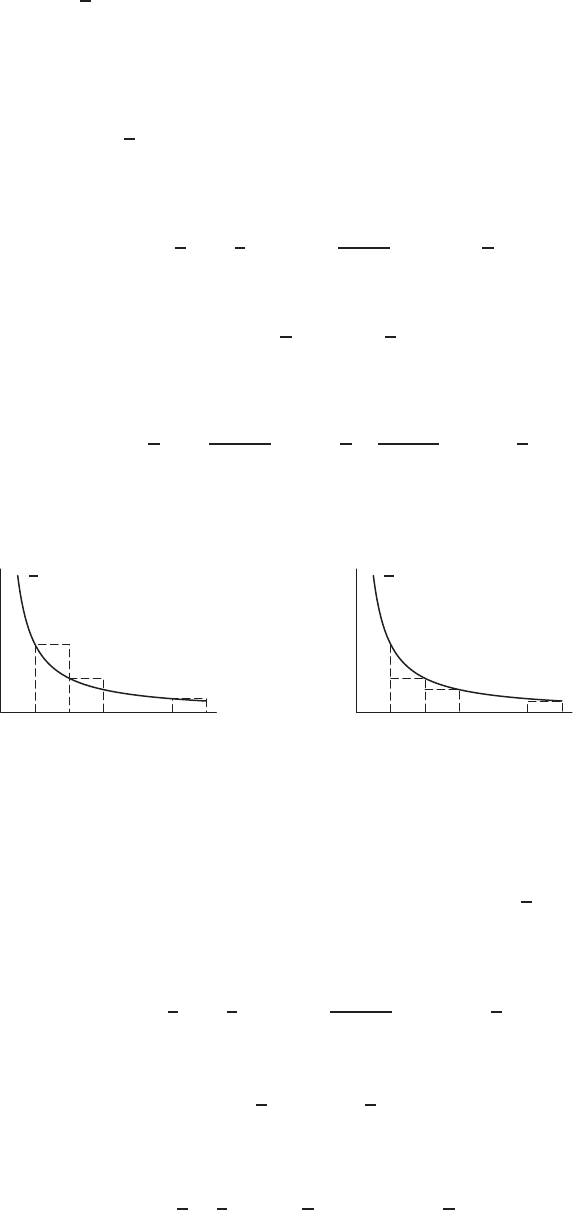
924 Chapter Nine /SOLUTIONS
97. We want to estimate
100,000
X
k=1
1
kusing left and right Riemann sum approximations to f(x) = 1/x on the interval 1≤
x≤100,000. Figure 9.10 shows a left Riemann sum approximation with 99,999 terms. Since f(x)is decreasing, the left
Riemann sum overestimates the area under the curve. Figure 9.10 shows that the first term in the sum is f(1) ·1and the
last is f(99,999) ·1, so we have
Z100,000
1
1
xdx < LHS =f(1) ·1 + f(2) ·1 + ···+f(99,999) ·1.
Since f(x) = 1/x, the left Riemann sum is
LHS =1
1·1 + 1
2·1 + · ·· +1
99,999 ·1 =
99,999
X
k=1
1
k,
so Z100,000
1
1
xdx <
99,999
X
k=1
1
k.
Since we want the sum to go k= 100,000 rather than k= 99,999, we add 1/100,000 to both sides:
Z100,000
1
1
xdx +1
100,000 <
99,999
X
k=1
1
k+1
100,000 =
100,000
X
k=1
1
k.
The left Riemann sum has therefore given us an underestimate for our sum. We now use the right Riemann sum in
Figure 9.11 to get an overestimate for our sum.
1x1x2··· 100,000
1
x
x
Figure 9.10
1x1x2··· 100,000
1
x
x
Figure 9.11
The right Riemann sum again has 99,999 terms, but this time the sum underestimates the area under the curve.
Figure 9.11 shows that the first rectangle has area f(2) ·1and the last f(100,000) ·1, so we have
RHS =f(2) ·1 + f(3) ·1 + · ·· +f(100,000) ·1<Z100,000
1
1
xdx.
Since f(x) = 1/x, the right Riemann sum is
RHS =1
2·1 + 1
3·1 + ···+1
100,000 ·1 =
100,000
X
k=2
1
k.
So 100,000
X
k=2
1
k<Z100,000
1
1
xdx.
Since we want the sum to start at k= 1, we add 1 to both sides:
100,000
X
k=1
1
k=1
1+
100,000
X
k=2
1
k<1 + Z100,000
1
1
xdx.

PROJECTS FOR CHAPTER NINE 925
Putting these under- and overestimates together, we have
Z100,000
1
1
xdx +1
100,000 <
100,000
X
k=1
1
k<1 + Z100,000
1
1
xdx.
Since Z100,000
1
1
xdx = ln 100,000 −ln 1 = 11.513, we have
11.513 <
100,000
X
k=1
1
k<12.513.
Therefore we have
100,000
X
k=1
1
k≈12.
98. The argument is false. Property 1 of Theorem 9.2 only applies to convergent series. In addition, by the limits comparison
test with bn= 1/n2, the series converges.
PROJECTS FOR CHAPTER NINE
1. (a) The undiluted strength is 2 mg/ml, so the concentration of a 10-fold dilution is 0.2mg/ml and the concen-
tration of a 100-fold dilution is 0.02 mg/ml. Since each of the first 11 steps lasts 15 minutes = 0.25 hour,
the volume infused at each step is given, in ml, by
Volume =Rate ×Time =(Rate, in ml/hr) ×(0.25 hr).
The dose administered is given, in mg, by
Dose =Concentration ×Volume =(Concentration, in mg/ml) ×(Rate, in ml/hr) ×(0.25 hr).
Thus in the first step, the concentration is 0.02 mg/ml and
Dose administered = 0.02 ×2.5×0.25 = 0.0125 mg.
At the second step,
Dose administered = 0.02 ×5.0×0.25 = 0.0250 mg,
and so on. See the first 11 rows in Table 9.1.
(b) Using the spreadsheet to find the cumulative dose given in the first 11 steps, we find that 25.5875 mg have
been administered. To reach the target dose of 500 mg,
Dose at 12th step =500 −25.5875 = 474.4125 mg.
The time required to deliver the 12th dose is
Time =Dose
Concentration ×Rate =474.4125 mg
2×51.2mg/hr = 4.633 hours = 278 minutes.
The volume infused at the last step is 4.633 ·51.2 = 237.21 ml. See the last row in Table 9.1.
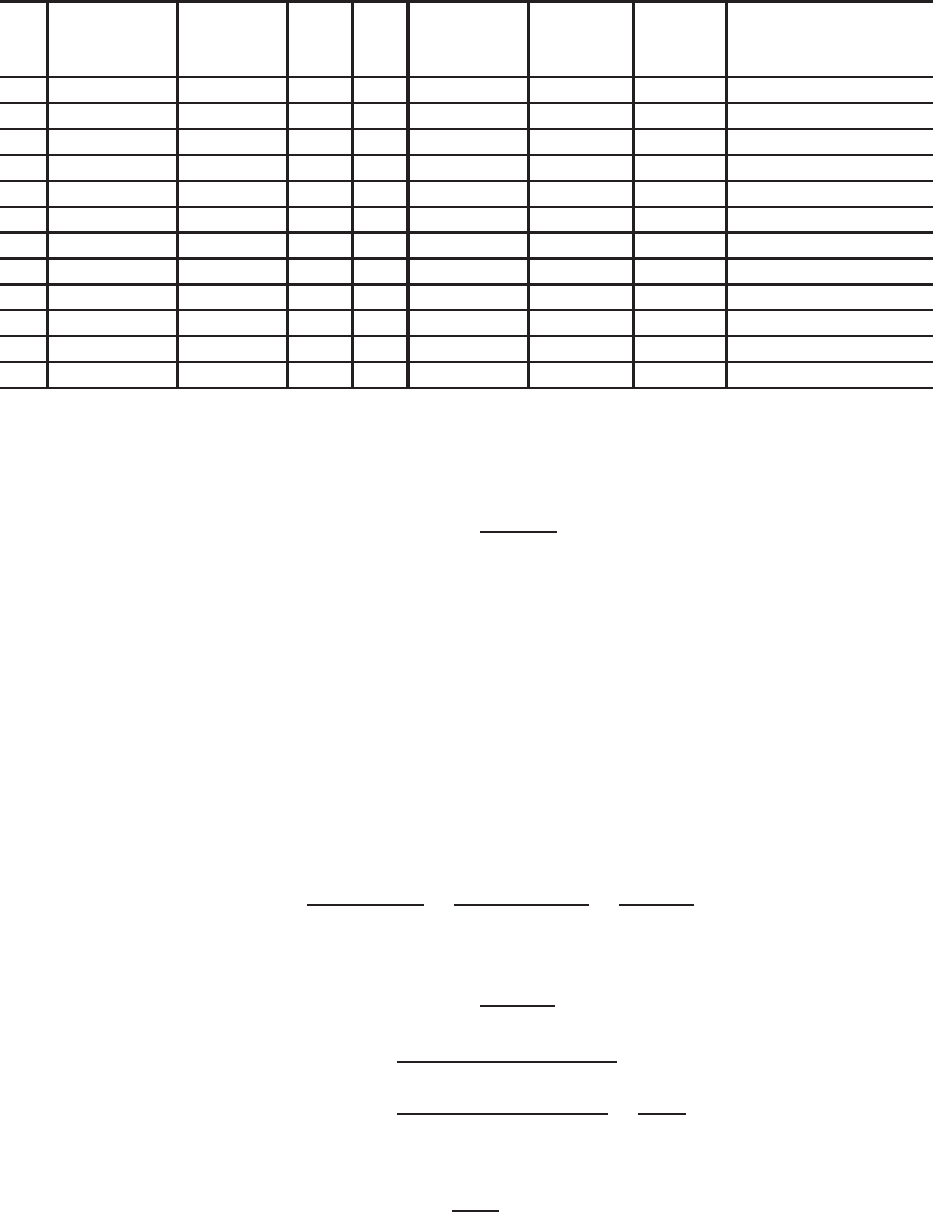
926 Chapter Nine /SOLUTIONS
Table 9.1
Ratio of dose administered
Concentration Rate Time Volume infused Dose infused Cumulative in this step to dose
Step Solution (mg/ml) (ml/hr) (min) per step (ml) per step (mg) dose (mg) administered in previous step
1 100-fold dilution 0.02 2.5 15 0.63 0.0125 0.0125
2 100-fold dilution 0.02 5.0 15 1.25 0.0250 0.0375 2
3 100-fold dilution 0.02 10.0 15 2.50 0.0500 0.0875 2
4 100-fold dilution 0.02 20.0 15 5.00 0.1000 0.1875 2
5 10-fold dilution 0.2 4.0 15 1.00 0.2000 0.3875 2
6 10-fold dilution 0.2 8.0 15 2.00 0.4000 0.7875 2
7 10-fold dilution 0.2 16.0 15 4.00 0.8000 1.5875 2
8 10-fold dilution 0.2 32.0 15 8.00 1.6000 3.1875 2
9undiluted 2 6.4 15 1.60 3.2000 6.3875 2
10 undiluted 2 12.8 15 3.20 6.4000 12.7875 2
11 undiluted 2 25.6 15 6.40 12.8000 25.5875 2
12 undiluted 2 51.2 278 237.21 474.4125 500
(c) The dose starts at 0.0125 mg and increases by a factor of 2 at each step. Hence if Dnis the dose at step n,
we have a geometric series with terms D1= 0.0125,D2= 0.0125 ·2,..., and Dn= 0.0125 ·2n−1. Thus,
Total dose in 11 steps = 0.0125 + 0.0125 ·2 + ···+ 0.0125 ·210
= 0.0125 (211 −1)
2−1= 25.5875 mg.
which agrees with the value computed in the spreadsheet in part (a).
(d) The first 11 fifteen minute doses take 2 hours 45 minutes. Adding the 4.63 hours, or 4 hours and 38
minutes, for the 12th dose, we see that to administer the full target dose of 500 mg requires 7 hours 23
minutes, about 7 and a half hours.
2. (a) To show fis decreasing for x > 1, we look at f′(x):
f′(x)=n(n+ 1)xn−1−n(n+ 1)xn=n(n+ 1)xn−1(1 −x).
Thus, for x > 1, we have f′(x)<0, so fis decreasing. Since f(1) = 1, this means f(x)<1for x > 1.
Factoring xnout of f(x), we get
f(x) = (n+ 1)xn−nxn+1 =xn(n+ 1 −nx)<1.
(b) We simplify the value of x
x=1+1/n
1+1/(n+ 1) =(n+ 1)/n
(n+ 2)/(n+ 1) =(n+ 1)2
n(n+ 2).
Before substituting into xn(n+ 1 −nx)<1, we calculate
n+ 1 −nx =n+ 1 −n(n+ 1)2
n(n+ 2)
=(n+ 1)(n+ 2) −(n+ 1)2
n+ 2
=(n+ 1)(n+ 2 −(n+ 1))
n+ 2 =n+ 1
n+ 2.
Thus, substituting into the inequality from part (a), xn(n+ 1 −nx)<1, gives
xnn+ 1
n+ 2<1.
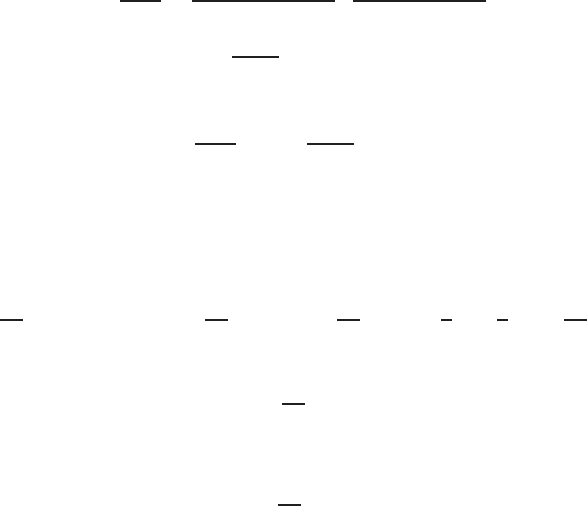
PROJECTS FOR CHAPTER NINE 927
(c) We want to show sn< sn+1. Since sn= (1 + 1/n)nand sn+1 = (1 + 1/(n+ 1))n+1, using the
definition of x, we have
sn
sn+1
=(1 + 1/n)n
(1 + 1/(n+ 1))n·1
(1 + 1/(n+ 1))
=xnn+ 1
n+ 2 .
Thus, by part (b), we have
sn
sn+1
=xnn+1
n+ 2 <1,
so
sn< sn+1.
Thus, the sequence is increasing.
(d) Substituting x= 1 + 1/2ninto the inequality from part (a) gives
1 + 1
2nnn+ 1 −n1 + 1
2n=1 + 1
2nn1−1
2=1
21 + 1
2nn
<1.
Thus 1 + 1
2nn
<2.
(e) When we square this inequality, we get
1 + 1
2n2n
<4,
that is, for all n
s2n<4.
Thus, the even terms are bounded above by 4. Because we have shown the sequence is increasing, for each
odd term, we have
s2n−1<22n<4,
so the odd terms are also bounded above by 4. Since all terms are bounded below by 0, the sequence is
bounded.
(f) From parts (c) and (e), we know that the sequence is increasing and bounded, and therefore, by Theo-
rem 9.1, it has a limit.
3. (a) (i) p2
(ii) There are two ways to do this. One way is to compute your opponent’s probability of winning two in
a row, which is (1 −p)2. Then the probability that neither of you win the next points is:
1−(Probability you win next two +Probability opponent wins next two)
= 1 −(p2+ (1 −p)2)
= 1 −(p2+ 1 −2p+p2)
=2p2−2p
= 2p(1 −p).
The other way to compute this is to observe either you win the first point and lose the second or vice
versa. Both have probability p(1 −p), so the probability you split the points is 2p(1 −p).
(iii)
Probability =(Probability of splitting next two) ·(Probability of winning two after that)
= 2p(1 −p)p2
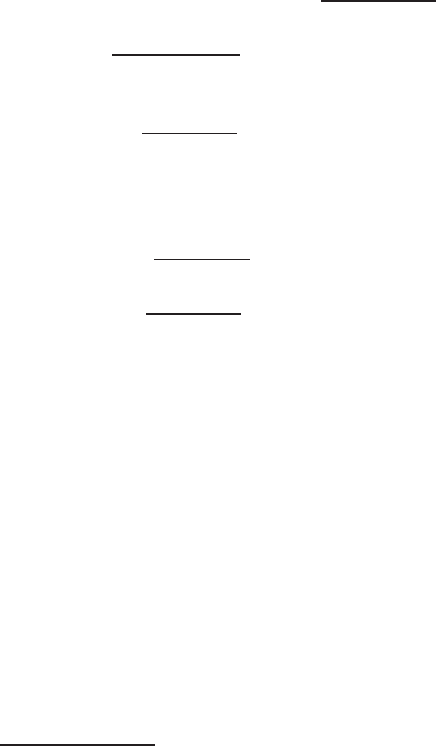
928 Chapter Nine /SOLUTIONS
(iv)
Probability =(Probability of winning next two) +(Probability of splitting next two,
winning two after that)
=p2+ 2p(1−p)p2
(v) The probability is:
w=(Probability of winning first two)
+(Probability of splitting first two)·(Probability of winning next two)
+(Prob. of split. first two)·(Prob. of split. next two)·(Prob. of winning next two)
+···
=p2+ 2p(1−p)p2+ (2p(1 −p))2p2+···.
This is an infinite geometric series with a first term of p2and a ratio of 2p(1−p). Therefore the
probability of winning is
w=p2
1−2p(1 −p).
(vi) For p= 0.5,w=(0.5)2
1−2(0.5)(1−(0.5)) = 0.5. This is what we would expect. If you and your opponent
are equally likely to score the next point, you and your opponent are equally likely to win the next
game.
For p= 0.6,w=(0.6)2
1−2(0.6)(0.4) = 0.69. Here your probability of winning the next point has been
magnified to a probability 0.69 of winning the game. Thus it gives the better player an advantage to
have to win by two points, rather than the “sudden death” of winning by just one point. This makes
sense: when you have to win by two, the stronger player always gets a second chance to overcome the
weaker player’s winning the first point on a “fluke.”
For p= 0.7,w=(0.7)2
1−2(0.7)(0.3) = 0.84. Again, the stronger player’s probability of winning is
magnified.
For p= 0.4,w=(0.4)2
1−2(0.4)(0.6) = 0.31. We already computed that for p= 0.6,w= 0.69. Thus
the value for wwhen p= 0.4, should be the same as the probability of your opponent winning for
p= 0.6, namely 1−0.69 = 0.31.
(b) (i)
S=(Prob. you score first point)
+(Prob. you lose first point, your opponent loses the next,
you win the next)
+(Prob. you lose a point, opponent loses, you lose,
opponent loses, you win)
+···
=(Prob. you score first point)
+(Prob. you lose)·(Prob. opponent loses)·(Prob. you win)
+(Prob. you lose)·(Prob. opponent loses)·(Prob. you lose)
·(Prob. opponent loses)·(Prob. you win)+···
=p+ (1 −p)(1 −q)p+ ((1 −p)(1 −q))2p+···
=p
1−(1 −p)(1 −q)
(ii) Since Sis your probability of winning the next point, we can use the formula computed in part (v) of (a)

PROJECTS FOR CHAPTER NINE 929
for winning two points in a row, thereby winning the game:
w=S2
1−2S(1 −S).
•When p= 0.5and q= 0.5,
S=0.5
1−(0.5)(0.5) = 0.67.
Therefore
w=S2
1−2S(1 −S)=(0.67)2
1−2(0.67)(1 −0.67) = 0.80.
•When p= 0.6and q= 0.5,
S=0.6
1−(0.4)(0.5) = 0.75 and w=(0.75)2
1−2(0.75)(1 −0.75) = 0.9.
4. (a) (i) Amount remaining =Amount taken ·x= 5 ·8xmg.
(ii) Amount remaining =Amount remaining from first dose +Amount of second dose = 5 ·8x+ 5 ·7 =
5(8x+ 7) mg.
(iii) Amount remaining =Sum of amounts remaining from previous doses = 5 ·8x2+ 5 ·7x+5·6 =
5(8x2+ 7x+ 6) mg.
(iv) Amount remaining = 5(8x7+ 7x6+ 6x5+··· + 2x+ 1) mg.
(v) Amount remaining = 5(8x7+ 7x6+ 6x5+··· + 2x+ 1)xmg.
(vi) Amount remaining = 5(8x7+ 7x6+ 6x5+··· + 2x+ 1)xnmg.
(b) Notice that the sum looks like a geometric series, except that each term has been differentiated. If we
differentiate the finite geometric series
S9= 1 + x+x2+··· +x8=1−x9
1−x
we have
dS9
dx = 0 + 1 + 2x+···+ 8x7=d
dx 1−x9
1−x=−9x8(1 −x)−(1−x9)(−1)
(1 −x)2=8x9−9x8+ 1
(1 −x)2.
Thus, we see that
T= 8x7+ 7x6+ 6x5+··· + 2x+ 1 = 8x9−9x8+ 1
(1 −x)2.
(c) Let nbe the number of days since the eighth dose was taken. Then
Amount of prednisone in the body = 5(8x7+ 7x6+ 6x5+··· + 2x+ 1)xn= 5 8x9−9x8+ 1
(1 −x)2xnmg.
If the half-life of prednisone is 24 hours, then x= 1/2 = 0.5, so
Amount of prednisone in the body after ndays = 5 8(0.5)9−9(0.5)8+ 1
(1 −(0.5))2(0.5)n= 19.6094(0.5)nmg.
We want this to be 3% of one tablet, that is 0.03 ×5 = 0.15 mg, so we need to solve for n:
19.6094(0.5)n= 0.15.
This leads to
(0.5)n=0.15
19.6094,
so
n=ln(0.15/19.6094)
ln(0.5) = 7.037 ≈7days.

930 Chapter Nine /SOLUTIONS
(d) The amount of prednisone in the body is the sum of the amounts remaining from the previous doses. The
first dose of ntablets was (n−1) days before, so
Number of tablets remaining from first dose =nxn−1.
The dose of (n−1) tablets was (n−2) days before, so
Number of tablets remaining from second dose = (n−1)xn−2.
Adding similar terms, ending with the last dose of 1 table which just occurred, gives the total number of
tablets remaining:
Tn=nxn−1+ (n−1)xn−2+··· + 2x+ 1.
To find a closed form for the sum, we differentiate the finite geometric series
Sn+1= 1 + x+x2+··· +xn=1−xn+1
1−x,
giving
dSn+1
dx =0+1+2x+···+nxn−1=d
dx 1−xn+1
1−x=−(n+ 1)xn(1 −x)−(1 −xn+1)(−1)
(1 −x)2.
Thus, we see that
Tn=nxn−1+ (n−1)xn−2+··· + 2x+ 1 = nxn+1 −(n+ 1)xn+ 1
(1 −x)2.

10.1 SOLUTIONS 931
CHAPTER TEN
Solutions for Section 10.1
Exercises
1. Let f(x) = 1
1−x= (1 −x)−1.Then f(0) = 1.
f′(x) = 1!(1 −x)−2f′(0) = 1!,
f′′(x) = 2!(1 −x)−3f′′(0) = 2!,
f′′′(x) = 3!(1 −x)−4f′′′(0) = 3!,
f(4)(x) = 4!(1 −x)−5f(4)(0) = 4!,
f(5)(x) = 5!(1 −x)−6f(5)(0) = 5!,
f(6)(x) = 6!(1 −x)−7f(6)(0) = 6!,
f(7)(x) = 7!(1 −x)−8f(7)(0) = 7!.
P3(x) = 1 + x+x2+x3,
P5(x) = 1 + x+x2+x3+x4+x5,
P7(x) = 1 + x+x2+x3+x4+x5+x6+x7.
2. Let 1
1 + x= (1 + x)−1.Then f(0) = 1.
f′(x) = −1!(1 + x)−2f′(0) = −1,
f′′(x) = 2!(1 + x)−3f′′(0) = 2!,
f′′′(x) = −3!(1 + x)−4f′′′(0) = −3!,
f(4)(x) = 4!(1 + x)−5f(4)(0) = 4!,
f(5)(x) = −5!(1 + x)−6f(5)(0) = −5!,
f(6)(x) = 6!(1 + x)−7f(6)(0) = 6!,
f(7)(x) = −7!(1 + x)−8f(7)(0) = −7!,
f(8)(x) = 8!(1 + x)−9f(8)(0) = 8!.
P4(x) = 1 −x+x2−x3+x4,
P6(x) = 1 −x+x2−x3+x4−x5+x6,
P8(x) = 1 −x+x2−x3+x4−x5+x6−x7+x8.
3. Let f(x) = √1 + x= (1 + x)1/2.Then f(0) = 1, and
f′(x) = 1
2(1 + x)−1/2f′(0) = 1
2,
f′′(x) = −1
4(1 + x)−3/2f′′(0) = −1
4,
f′′′(x) = 3
8(1 + x)−5/2f′′′(0) = 3
8,
f(4)(x) = −15
16 (1 + x)−7/2f(4)(0) = −15
16 .
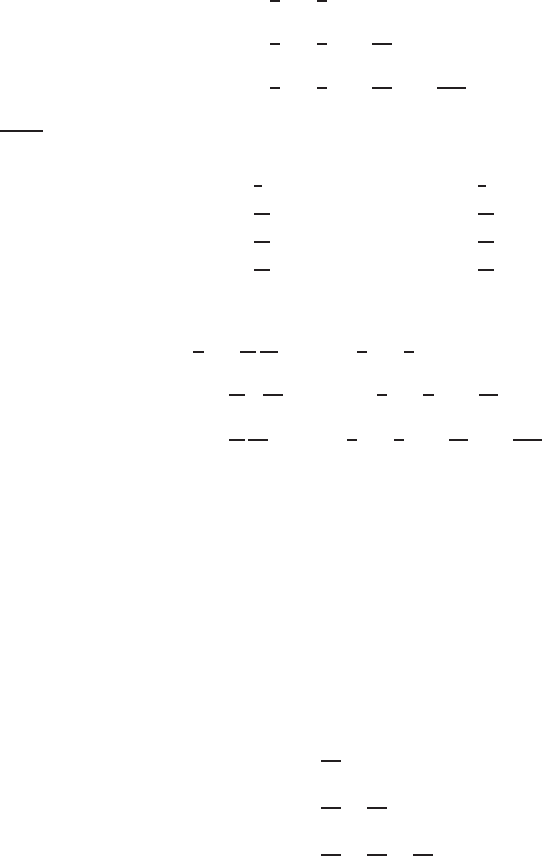
932 Chapter Ten /SOLUTIONS
Thus,
P2(x) = 1 + 1
2x−1
8x2,
P3(x) = 1 + 1
2x−1
8x2+1
16 x3,
P4(x) = 1 + 1
2x−1
8x2+1
16 x3−5
128 x4.
4. Let f(x) = 3
√1−x= (1 −x)1/3.Then f(0) = 1, and
f′(x) = −1
3(1 −x)−2/3f′(0) = −1
3,
f′′(x) = −2
32(1 −x)−5/3f′′(0) = −2
32,
f′′′(x) = −10
33(1 −x)−8/3f′′′(0) = −10
33,
f(4)(x) = −80
34(1 −x)−11/3f(4)(0) = −80
34.
Then,
P2(x) = 1 −1
3x−1
2!
2
32x2= 1 −1
3x−1
9x2,
P3(x) = P2(x)−1
3! 10
33x3= 1 −1
3x−1
9x2−5
81 x3,
P4(x) = P3(x)−1
4!
80
34x4= 1 −1
3x−1
9x2−5
81 x3−10
243 x4.
5. Let f(x) = cos x. Then f(0) = cos(0) = 1, and
f′(x) = −sin x f′(0) = 0,
f′′(x) = −cos x f′′(0) = −1,
f′′′(x) = sin x f′′′(0) = 0,
f(4)(x) = cos x f(4)(0) = 1,
f(5)(x) = −sin x f(5)(0) = 0,
f(6)(x) = −cos x f(6)(0) = −1.
Thus,
P2(x) = 1 −x2
2! ,
P4(x) = 1 −x2
2! +x4
4! ,
P6(x) = 1 −x2
2! +x4
4! −x6
6! .
6. Let f(x) = ln(1 + x).Then f(0) = ln 1 = 0, and
f′(x) = (1 + x)−1f′(0) = 1,
f′′(x) = (−1)(1 + x)−2f′′(0) = −1,
f′′′(x) = 2(1 + x)−3f′′′(0) = 2,
f(4)(x) = −3!(1 + x)−4f(4)(0) = −3!,
f(5)(x) = 4!(1 + x)−5f(5)(0) = 4!,
f(6)(x) = −5!(1 + x)−6f(6)(0) = −5!,
f(7)(x) = 6!(1 + x)−7f(7)(0) = 6!,
f(8)(x) = −7!(1 + x)−8f(8)(0) = −7!,
f(9)(x) = 8!(1 + x)−9f(9)(0) = 8!.
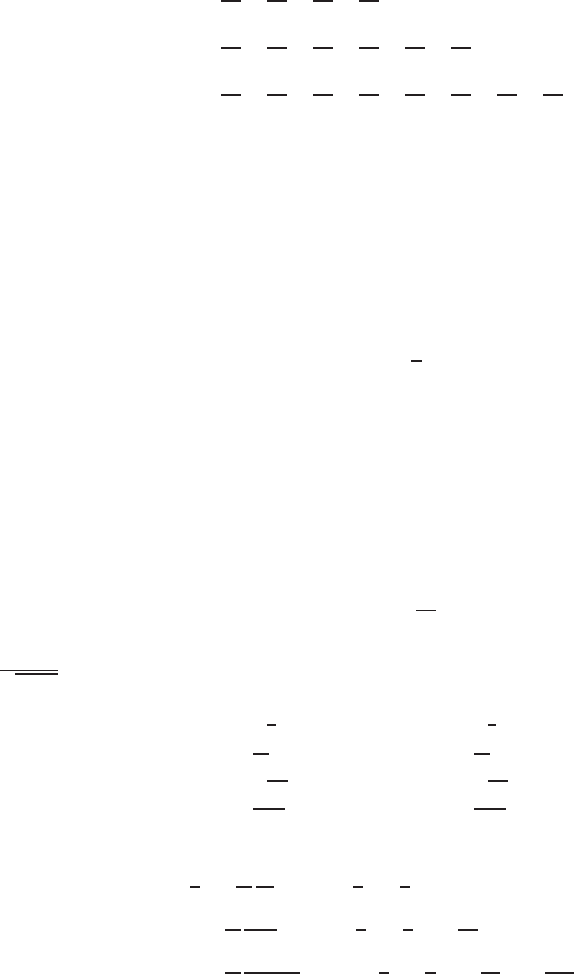
10.1 SOLUTIONS 933
So,
P5(x) = x−x2
2+x3
3−x4
4+x5
5,
P7(x) = x−x2
2+x3
3−x4
4+x5
5−x6
6+x7
7,
P9(x) = x−x2
2+x3
3−x4
4+x5
5−x6
6+x7
7−x8
8+x9
9.
7. Let f(x) = arctan x. Then f(0) = arctan 0 = 0, and
f′(x) = 1/(1 + x2) = (1 + x2)−1f′(0) = 1,
f′′(x) = (−1)(1 + x2)−22x f′′(0) = 0,
f′′′(x) = 2!(1 + x2)−322x2+ (−1)(1 + x2)−22f′′′(0) = −2,
f(4)(x) = −3!(1 + x2)−423x3+ 2!(1 + x2)−323x
+ 2!(1 + x2)−322x f (4)(0) = 0.
Therefore,
P3(x) = P4(x) = x−1
3x3.
8. Let f(x) = tan x. So f(0) = tan 0 = 0, and
f′(x) = 1/cos2x f′(0) = 1,
f′′(x) = 2 sin x/ cos3x f ′′(0) = 0,
f′′′(x) = (2/cos2x) + (6 sin2x/ cos4x)f′′′(0) = 2,
f(4)(x) = (16 sin x/ cos3x) + (24 sin3x/ cos5x)f(4)(0) = 0.
Thus,
P3(x) = P4(x) = x+x3
3.
9. Let f(x) = 1
√1 + x= (1 + x)−1/2.Then f(0) = 1.
f′(x) = −1
2(1 + x)−3/2f′(0) = −1
2,
f′′(x) = 3
22(1 + x)−5/2f′′(0) = 3
22,
f′′′(x) = −3·5
23(1 + x)−7/2f′′′(0) = −3·5
23,
f(4)(x) = 3·5·7
24(1 + x)−9/2f(4)(0) = 3·5·7
24
Then,
P2(x)= 1 −1
2x+1
2!
3
22x2= 1 −1
2x+3
8x2,
P3(x) = P2(x)−1
3!
3·5
23x3= 1 −1
2x+3
8x2−5
16 x3,
P4(x) = P3(x) + 1
4!
3·5·7
24x4= 1 −1
2x+3
8x2−5
16 x3+35
128 x4.
10. Let f(x) = (1 + x)p.
(a) Suppose that p= 0. Then f(x) = 1 and f(k)(x) = 0 for any k≥1.Thus P2(x) = P3(x) = P4(x) = 1.
(b) If p= 1 then f(x) = 1 + x, so
f(0) = 1,
f′(x) = 1,
f(k)(x) = 0 k≥2.
Thus P2(x) = P3(x) = P4(x) = 1 + x.
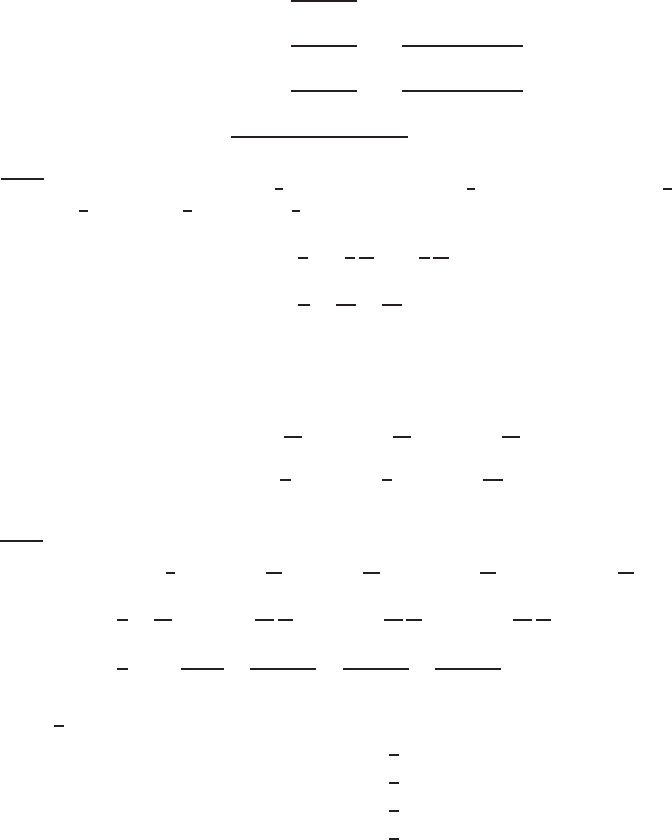
934 Chapter Ten /SOLUTIONS
(c) In general:
f(x) = (1 + x)p,
f′(x) = p(1 + x)p−1,
f′′(x) = p(p−1)(1 + x)p−2,
f′′′(x) = p(p−1)(p−2)(1 + x)p−3,
f(4)(x) = p(p−1)(p−2)(p−3)(1 + x)p−4.
f(0) = 1,
f′(0) = p,
f′′(0) = p(p−1),
f′′′(0) = p(p−1)(p−2),
f(4)(0) = p(p−1)(p−2)(p−3).
P2(x) = 1 + px +p(p−1)
2x2,
P3(x) = 1 + px +p(p−1)
2x2+p(p−1)(p−2)
6x3,
P4(x) = 1 + px +p(p−1)
2x2+p(p−1)(p−2)
6x3
+p(p−1)(p−2)(p−3)
24 x4.
11. Let f(x) = √1−x= (1−x)1/2. Then f′(x) = −1
2(1−x)−1/2,f′′(x) = −1
4(1−x)−3/2,f′′′(x) = −3
8(1−x)−5/2.
So f(0) = 1,f′(0) = −1
2,f′′(0) = −1
4,f′′′(0) = −3
8, and
P3(x) = 1 −1
2x−1
4
1
2! x2−3
8
1
3! x3
= 1 −x
2−x2
8−x3
16 .
12. Let f(x) = ex.Since f(k)(x) = ex=f(x)for all k≥1, the Taylor polynomial of degree 4for f(x) = exabout x= 1
is
P4(x) = e1+e1(x−1) + e1
2! (x−1)2+e1
3! (x−1)3+e1
4! (x−1)4
=eh1 + (x−1) + 1
2(x−1)2+1
6(x−1)3+1
24 (x−1)4i.
13. Let f(x) = 1
1 + x= (1 + x)−1. Then f′(x) = −(1 + x)−2,f′′(x) = 2(1 + x)−3,f′′′(x) = −6(1 + x)−4,
f(4)(x) = 24(1 + x)−5. So f(2) = 1
3,f′(2) = −1
32,f′′(2) = 2
33,f′′′(2) = −6
34, and f(4)(2) = 24
35. Therefore,
P4(x) = 1
3−1
32(x−2) + 2
33
1
2! (x−2)2−6
34
1
3! (x−2)3+24
35
1
4! (x−2)4
=1
31−x−2
3+(x−2)2
32−(x−2)3
33+(x−2)4
34.
14. Let f(x) = cos x.f(π
2) = 0.
f′(x) = −sin x f′(π
2) = −1,
f′′(x) = −cos x f′′(π
2) = 0,
f′′′(x) = sin x f′′′(π
2) = 1,
f(4)(x) = cos x f(4)(π
2) = 0.
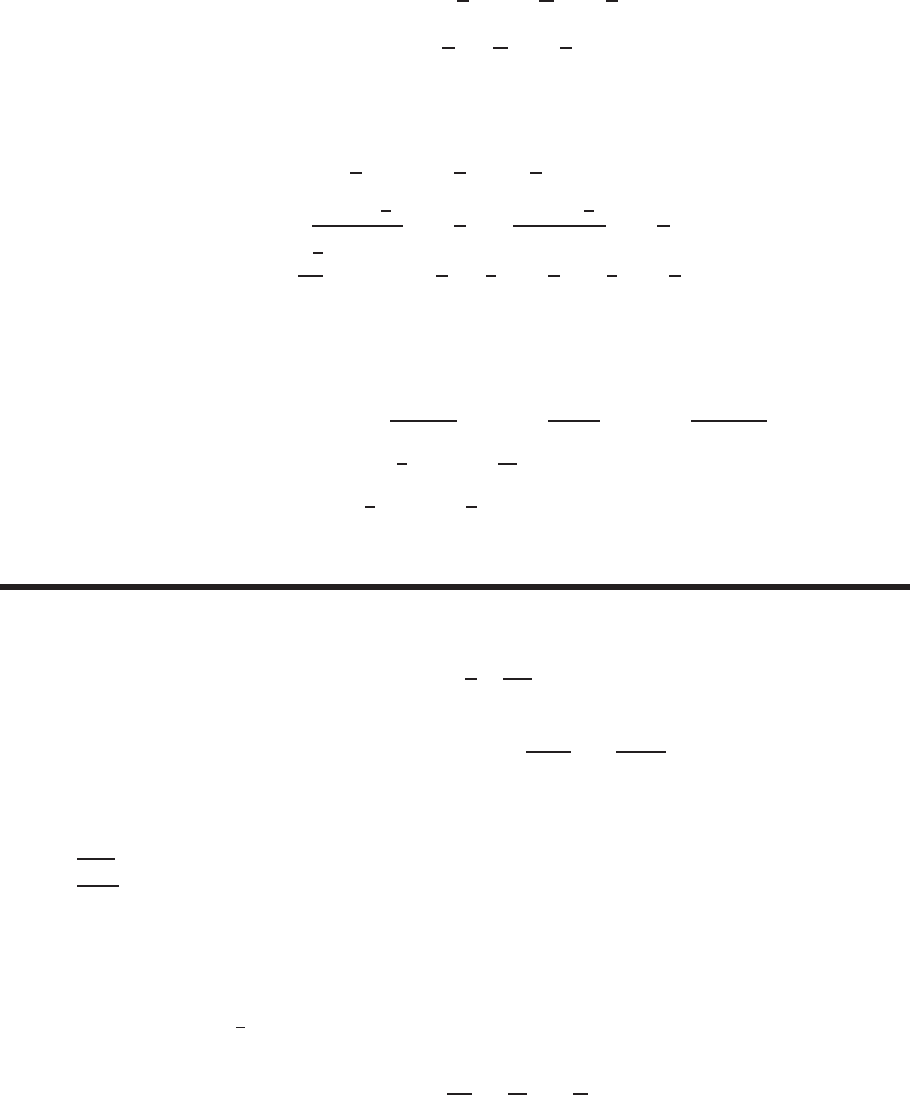
10.1 SOLUTIONS 935
So,
P4(x) = 0 −x−π
2+ 0 + 1
3! x−π
23
=−x−π
2+1
3! x−π
23
.
15. Let f(x) = sin x.
Then f′(x) = cos x,f′′(x) = −sin x, and f′′′(x) = −cos x, so the Taylor polynomial for sin xof degree three about
x=−π/4is
P3(x) = sin −π
4+ cos −π
4x+π
4
+−sin −π
4
2! x+π
42
+−cos −π
4
3! x+π
43
=√2
2−1 + x+π
4+1
2x+π
42
−1
6x+π
43.
16. Let f(x) = ln(x2).Then ln(12) = ln 1 = 0.
Then f′(x) = 2x−1,f′′(x) = −2x−2,f′′′(x) = 4x−3, and f(4)(x) = −12x−4.
The Taylor polynomial of degree 4for f(x) = ln(x2)about x= 1 is
P4(x) = ln(12) + 2 ·1−1(x−1) + −2·1−2
2! (x−1)2+4·1−3
3! (x−1)3+−12 ·1−4
4! (x−1)4
= 0 + 2(x−1) −(x−1)2+4
6(x−1)3−12
24 (x−1)4
= 2(x−1) −(x−1)2+2
3(x−1)3−1
2(x−1)4.
Problems
17. The third degree Taylor polynomial of f(x)will have the same terms as the seventh degree polynomial but only up to the
x3term. So the third degree Taylor polynomial of f(x)is given by
P3(x) = 1 −x
3+5x2
7+ 8x3.
18. Using the fact that
f(x)≈P3(x) = f(0) + f′(0)x+f′′(0)
2! x2+f′′′(0)
3! x3
and identifying coefficients with those given for P3(x), we obtain the following:
(a) f(0) = constant term which equals 2, so f(0) = 2.
(b) f′(0) = coefficient of xwhich equals −1, so f′(0) = −1.
(c) f′′(0)
2! =coefficient of x2which equals −1/3, so f′′(0) = −2/3.
(d) f′′′(0)
3! =coefficient of x3which equals 2, so f′′′(0) = 12.
19.
f(x) = 4x2−7x+ 2 f(0) = 2
f′(x) = 8x−7f′(0) = −7
f′′(x) = 8 f′′(0) = 8,
so P2(x) = 2 + (−7)x+8
2x2= 4x2−7x+ 2.We notice that f(x) = P2(x)in this case.
20. f′(x) = 3x2+ 14x−5,f′′(x) = 6x+ 14,f′′′(x) = 6. Thus, about a= 0,
P3(x) = 1 + −5
1! x+14
2! x2+6
3! x3
= 1 −5x+ 7x2+x3
=f(x).
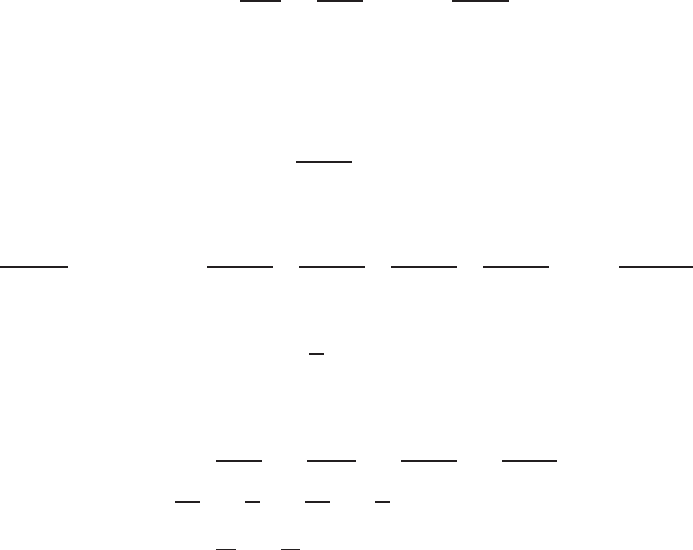
936 Chapter Ten /SOLUTIONS
21. (a) We’ll make the following conjecture:
“If f(x)is a polynomial of degree n, i.e.
f(x) = a0+a1x+a2x2+···+an−1xn−1+anxn,
then Pn(x), the nth degree Taylor polynomial for f(x)about x= 0, is f(x)itself.”
(b) All we need to do is to calculate Pn(x), the nth degree Taylor polynomial for fabout x= 0 and see if it is the same
as f(x).
f(0) = a0;
f′(0) = (a1+ 2a2x+···+nanxn−1)x=0
=a1;
f′′(0) = (2a2+ 3 ·2a3x+···+n(n−1)anxn−2)x=0
= 2!a2.
If we continue doing this, we’ll see in general
f(k)(0) = k!ak, k = 1,2,3,···, n.
Therefore,
Pn(x) = f(0) + f′(0)
1! x+f′′(0)
2! x2+···+f(n)(0)
n!xn
=a0+a1x+a2x2+···+anxn
=f(x).
22. Since the coefficient of (x−1)5term of p(x)is given by
C5=f(5)(1)
5! ,
we know that f(5) (1) = 5!C5. Note that
p(x) =
10
X
n=0
(x−1)n
n!= 1 + (x−1) + (x−1)2
2! +(x−1)3
3! +(x−1)4
4! +(x−1)5
5! +···+(x−1)10
10! ,
so C5= 1/5!. Therefore
f(5)(1) = 1
5! 5! = 1.
23. Referring to the table, we have:
P5(x) = f(0) + f′(0)x+f′′(0)
2! x2+f′′′(0)
3! x3+f(4)(0)
4! x4+f(5)(0)
5! x5
=−3 + 5x+−2
2! x2+0
3! x3+−1
4! x4+4
5! x5
=−3 + 5x−x2−1
24 x4+1
30 x5.
24. Referring to the formula for f(n)(0), we have:
f′(0) = f(1)(0) = −(−2)1= 2
f′′(0) = f(2)(0) = −(−2)2=−4
f′′′(0) = f(3) (0) = −(−2)3= 8
f(4)(0) = −(−2)4=−16
f(5)(0) = −(−2)5= 32.

10.1 SOLUTIONS 937
Since f(0) = −1, we have
P5(x) = f(0) + f′(0)x+f′′(0)
2! x2+f′′′(0)
3! x3+f(4)
4! x4+f(5)(0)
5! x5
=−1 + 2x+−4
2! x2+8
3! x3+−16
4! x4+32
5! x5
=−1 + 2x−2x2+4
3x3−2
3x4+4
15 x5.
25. Since P2(x)is the second degree Taylor polynomial for f(x)about x= 0,P2(0) = f(0), which says a=f(0). Since
d
dx P2(x)x=0
=f′(0),
b=f′(0); and since
d2
dx2P2(x)x=0
=f′′(0),
2c=f′′(0). In other words, ais the y-intercept of f(x),bis the slope of the tangent line to f(x)at x= 0 and ctells us
the concavity of f(x)near x= 0. So c < 0since fis concave down; b > 0since fis increasing; a > 0since f(0) >0.
26. As we can see from Problem 25, ais the y-intercept of f(x),bis the slope of the tangent line to f(x)at x= 0 and ctells
us the concavity of f(x)near x= 0.
So a > 0,b < 0and c < 0.
27. As we can see from Problem 25, ais the y-intercept of f(x),bis the slope of the tangent line to f(x)at x= 0 and ctells
us the concavity of f(x)near x= 0.
So a < 0,b > 0and c > 0.
28. As we can see from Problem 25, ais the y-intercept of f(x),bis the slope of the tangent line to f(x)at x= 0 and ctells
us the concavity of f(x)near x= 0.
So a < 0,b < 0and c > 0.
29.
lim
x→0
sin x
x= lim
x→0
x−x3
3!
x= lim
x→01−x2
3! = 1.
30.
lim
x→0
1−cos x
x2= lim
x→0
1−(1 −x2
2! +x4
4! )
x2= lim
x→01
2−x2
4! =1
2.
31. For f(h) = eh,P4(h) = 1 + h+h2
2+h3
3! +h4
4! . So
(a)
lim
h→0
eh−1−h
h2= lim
h→0
P4(h)−1−h
h2
= lim
h→0
h2
2+h3
3! +h4
4!
h2
= lim
h→01
2+h
3! +h2
4!
=1
2.
(b)
lim
h→0
eh−1−h−h2
2
h3= lim
h→0
P4(h)−1−h−h2
2
h3
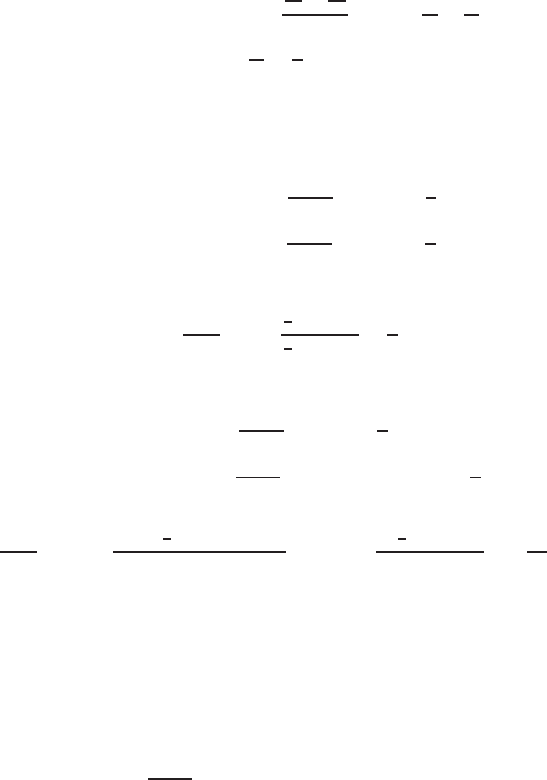
938 Chapter Ten /SOLUTIONS
= lim
h→0
h3
3! +h4
4!
h3= lim
h→01
3! +h
4!
=1
3! =1
6.
Using Taylor polynomials of higher degree would not have changed the results since the terms with higher powers of h
all go to zero as h→0.
32. (a) We use the Taylor polynomial of degree two for fand habout x= 2.
f(x)≈f(2) + f′(2)(x−2) + f′′(2)
2! (x−2)2=3
2(x−2)2
h(x)≈h(2) + h′(2)(x−2) + h′′(2)
2! (x−2)2=7
2(x−2)2
Thus, using the fact that near x= 2 we can approximate a function by Taylor polynomials
lim
x→2
f(x)
h(x)= lim
x→2
3
2(x−2)2
7
2(x−2)2=3
7.
(b) We use the Taylor polynomial of degree two for fand gabout x= 2.
f(x)≈f(2) + f′(2)(x−2) + f′′(2)
2! (x−2)2=3
2(x−2)2
g(x)≈g(2) + g′(2)(x−2) + g′′(2)
2! (x−2)2= 22(x−2) + 5
2(x−2)2.
Thus,
lim
x→2
f(x)
g(x)= lim
x→23
2(x−2)2
22(x−2) + 5(x−2)2= lim
x→23
2(x−2)
22 + 5(x−2) =0
22 = 0.
33. (a) Since the coefficient of the x-term of each fis 1, we know f′
1(0) = f′
2(0) = f′
3(0) = 1. Thus, each of the fs slopes
upward near 0, and are in the second figure.
The coefficient of the x-term in g1and in g2is 1, so g′
1(0) = g′
2(0) = 1. For g3however, g′
3(0) = −1. Thus,
g1and g2slope up near 0, but g3slopes down. The gs are in the first figure.
(b) Since g1(0) = g2(0) = g3(0) = 1, the point Ais (0,1).
Since f1(0) = f2(0) = f3(0) = 2, the point Bis (0,2).
(c) Since g3slopes down, g3is I. Since the coefficient of x2for g1is 2, we know
g′′
1(0)
2! = 2 so g′′
1(0) = 4.
By similar reasoning g′′
2(0) = 2. Since g1and g2are concave up, and g1has a larger second derivative, g1is III and
g2is II.
Calculating the second derivatives of the fs from the coefficients x2, we find
f′′
1(0) = 4 f′′
2(0) = −2f′′
3(0) = 2.
Thus, f1and f3are concave up, with f1having the larger second derivative, so f1is III and f3is II. Then f2is
concave down and is I.
34. Let f(x)be a function that has derivatives up to order nat x=a. Let
Pn(x) = C0+C1(x−a) + ··· +Cn(x−a)n
be the polynomial of degree nthat approximates f(x)about x=a. We require that Pn(x)and all of its first nderivatives
agree with those of the function f(x)at x=a, i.e., we want
f(a) = Pn(a),
f′(a) = P′
n(a),
f′′(a) = P′′
n(a),
.
.
.
f(n)(a) = P(n)
n(a).

10.1 SOLUTIONS 939
When we substitute x=ain Pn(x), all the terms except the first drop out, so
f(a) = C0.
Now differentiate Pn(x):
P′
n(x) = C1+ 2C2(x−a) + 3C3(x−a)2+···+nCn(x−a)n−1.
Substitute x=aagain, which yields
f′(a) = P′
n(a) = C1.
Differentiate P′
n(x):
P′′
n(x) = 2C2+ 3 ·2C3(x−a) + ···+n(n−1)Cn(x−a)n−2
and substitute x=aagain:
f′′(a) = P′′
n(a) = 2C2.
Differentiating and substituting again gives
f′′′(a) = P′′′
n(a) = 3 ·2C3.
Similarly,
f(k)(a) = Pn(k)(a) = k!Ck.
So, C0=f(a),C1=f′(a),C2=f′′(a)
2! ,C3=f′′′(a)
3! , and so on.
If we adopt the convention that f(0)(a) = f(a)and 0! = 1, then
Ck=f(k)(a)
k!, k = 0,1,2,···, n.
Therefore,
f(x)≈Pn(x) = C0+C1(x−a) + C2(x−a)2· ·· +Cn(x−a)n
=f(a) + f′(a)(x−a) + f′′(a)
2! (x−a)2+···+f(n)(a)
n!(x−a)n.
35. (a) The first degree Taylor polynomials P(x)and Q(x)for f(x)and g(x)near x= 0 and their product are given by
P(x) = 1 + x
Q(x) = 1 + 2x
P(x)Q(x) = 1 + 3x+ 2x2.
(b) The Taylor polynomial R(x)of degree 2 of h(x) = 1/(1 −x)(1 −2x)near x= 0 is
R(x) = 1 + 3x+ 7x2.
(c) The two polynomials R(x)and P(x)Q(x)are not the same. The product of Taylor polynomials of two functions is
usually not a Taylor polynomial of the product.
36. (a) The first degree Taylor polynomials P(x)and Q(x)for f(x)and g(x)near x= 0 and their product are given by
P(x) = f(0) + xf′(0)
Q(x) = g(0) + xg′(0)
P(x)Q(x) = f(0)g(0) + (f′(0)g(0) + f(0)g′(0))x+f′(0)g′(0)x2.
(b) The Taylor polynomial R(x)of degree 2 of h(x) = f(x)g(x)near x= 0 is
R(x) = f(0)g(0) + (f′(0)g(0) + f(0)g′(0))x+ (f′′(0)g(0) + 2f′(0)g′(0) + f(0)g′′(0))x2/2.
(c) The two polynomials R(x)and P(x)Q(x)are the same if the coefficients of x2are identical, that is
f′(0)g′(0) = (f′′(0)g(0) + 2f′(0)g′(0) + f(0)g′′(0))/2,
or
f′′(0)g(0) + f(0)g′′(0) = 0.
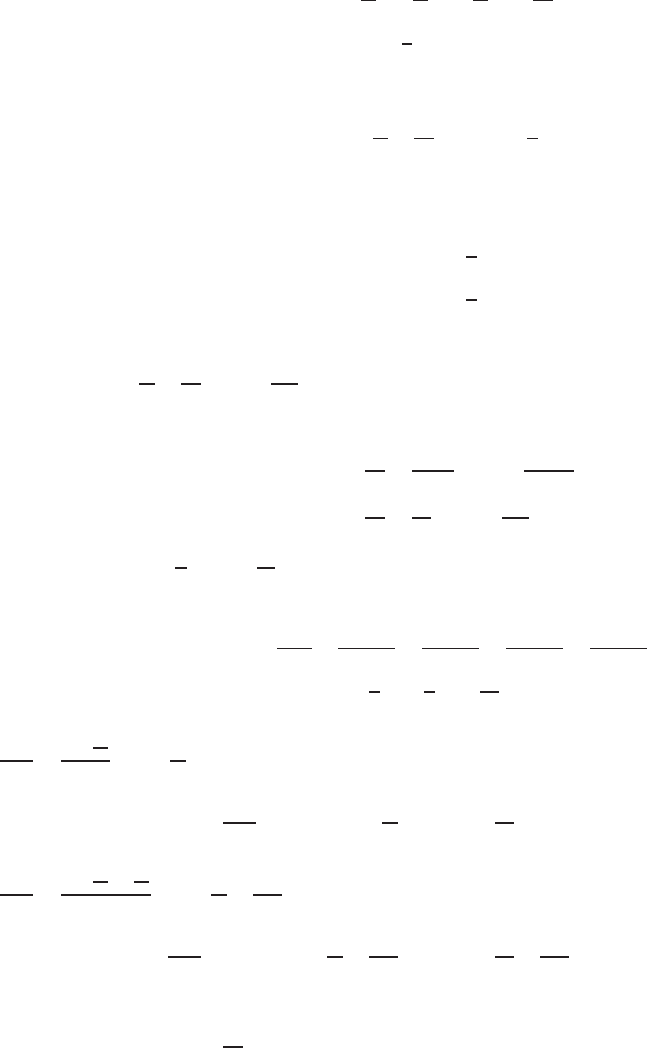
940 Chapter Ten /SOLUTIONS
37. (a) f(x) = ex2.
f′(x) = 2xex2,f′′(x) = 2(1 + 2x2)ex2,f′′′(x) = 4(3x+ 2x3)ex2,
f(4)(x) = 4(3 + 6x2)ex2+ 4(3x+ 2x3)2xex2.
The Taylor polynomial about x= 0 is
P4(x) = 1 + 0
1! x+2
2! x2+0
3! x3+12
4! x4
= 1 + x2+1
2x4.
(b) f(x) = ex. The Taylor polynomial of degree 2 is
Q2(x) = 1 + x
1! +x2
2! = 1 + x+1
2x2.
If we substitute x2for xin the Taylor polynomial for exof degree 2, we will get P4(x), the Taylor polynomial for
ex2of degree 4:
Q2(x2)= 1 + x2+1
2(x2)2
= 1 + x2+1
2x4
=P4(x).
(c) Let Q10(x) = 1 + x
1! +x2
2! +···+x10
10! be the Taylor polynomial of degree 10 for exabout x= 0. Then
P20(x) = Q10(x2)
= 1 + x2
1! +(x2)2
2! +··· +(x2)10
10!
= 1 + x2
1! +x4
2! +···+x20
10! .
(d) Let ex≈Q5(x) = 1 + x
1! +··· +x5
5! . Then
e−2x≈Q5(−2x)
= 1 + −2x
1! +(−2x)2
2! +(−2x)3
3! +(−2x)4
4! +(−2x)5
5!
= 1 −2x+ 2x2−4
3x3+2
3x4−4
15 x5.
38. (a) sin t
t≈t−t3
3!
t= 1 −t2
6
Z1
0
sin t
tdt ≈Z1
01−t2
6dt =t−t3
18
1
0
= 0.94444 ···
(b) sin t
t≈t−t3
3! +t5
5!
t= 1 −t2
6+t4
120
Z1
0
sin t
tdt ≈Z1
01−t2
6+t4
120 dt =t−t3
18 +t5
600
1
0
= 0.94611 ···
39. (a) The equation sin x= 0.2has one solution near x= 0 and infinitely many others, one near each multiple of π. See
Figure 10.1. The equation x−x3
3! = 0.2has three solutions, one near x= 0 and two others. See Figure 10.2.
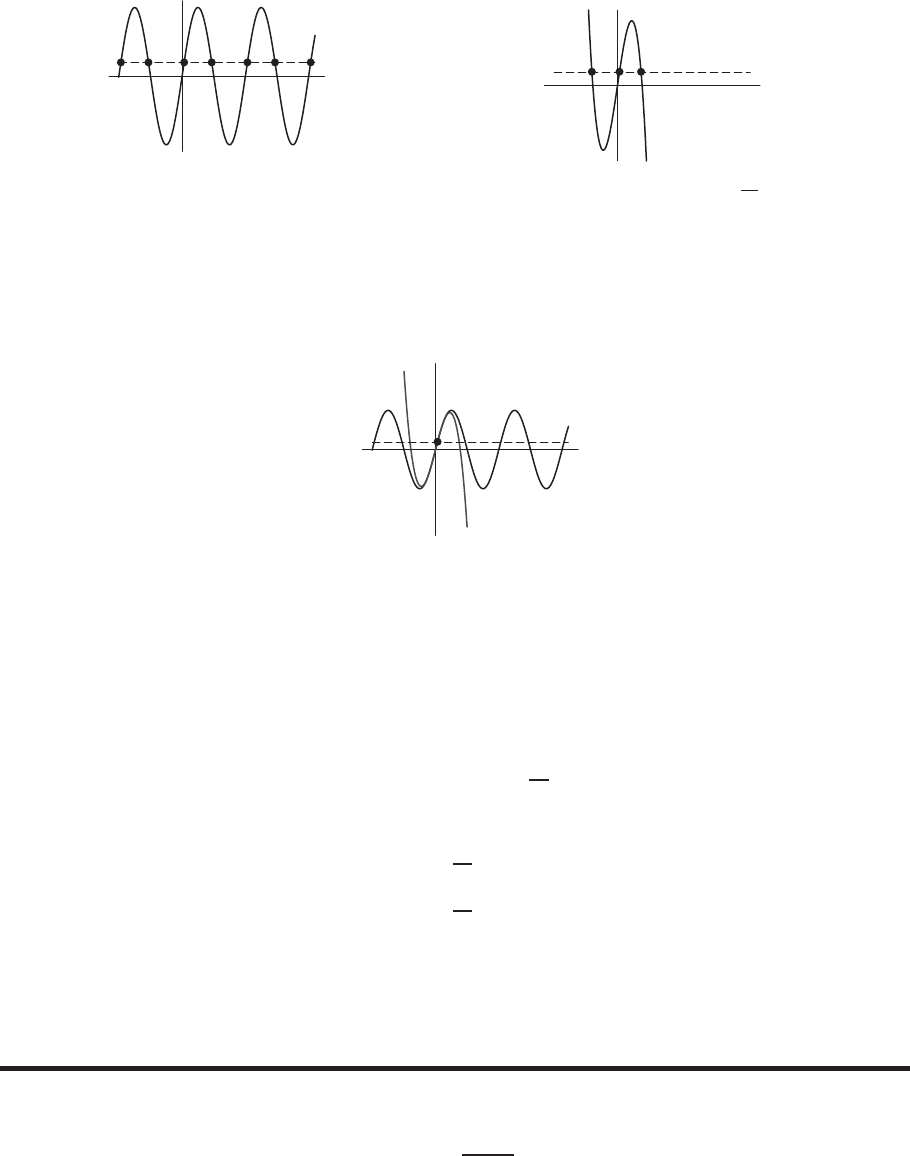
10.1 SOLUTIONS 941
y= 0.2
x
y
Figure 10.1
: Graph of y= sin xand y= 0.2
y= 0.2
x
y
Figure 10.2
: Graph of y=x−x3
3! and y= 0.2
(b) Near x= 0, the cubic Taylor polynomial x−x3/3! ≈sin x. Thus, the solutions to the two equations near x= 0 are
approximately equal. The other solutions are not close. The reason is that x−x3/3! only approximates sin xnear
x= 0 but not further away. See Figure 10.3.
sin x
y= 0.2
x−x3/3!
x
y
Figure 10.3
40. Changing sin θinto θmakes sense if the two values are almost equal. If we measure θin radians, this is true for values
of θclose to zero. (Recall the first degree Taylor polynomial: sin θ≈θ.) In other words, the switch is justified when the
pendulum does not swing very far from the vertical.
41. (a) The graphs of y= cos xand y= 1 −0.1xcross at x= 0 and for another x-value just to the right of x= 0. (There
are other crossings much further to the right.)
(b) Since
cos x≈1−x2
2
the equation becomes
1−x2
2= 1 −0.1x
x2
2= 0.1x
x= 0,0.2.
The solution x= 0 is an exact solution to the original equation; x= 0.2is an approximate solution to the original
equation.
Strengthen Your Understanding
42. The constant term of the Taylor polynomial is f(0), hence substituting 0 into f(x)gives ln(2) which is positive.
43. The coefficient of the xterm is given by f′(0) and f′(0) = 1.
44. An example is f(x) = sin x. Another example is f(x) = x
1 + x2. Many other examples are possible.
45. An example is p(x) = 1 + 3(x−1) + (x−1)3. Another example is p(x) = 5 + 3(x−1) + 2(x−1)2+ (x−1)3.
Many other examples are possible.
46. False. For example, both f(x) = x2and g(x) = x2+x3have P2(x) = x2.
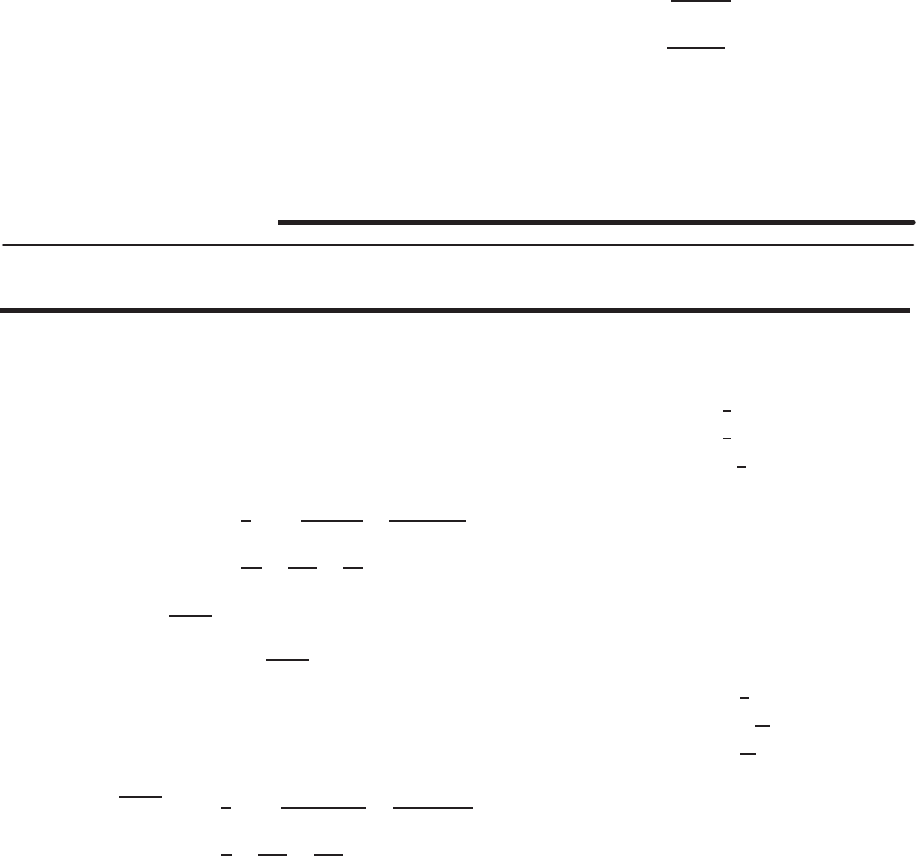
942 Chapter Ten /SOLUTIONS
47. False. The approximation sin θ≈θ−θ3/3! holds for θin radians, not degrees.
48. False. P2(x) = f(5) + f′(5)(x−5) + (f′′(5)/2)(x−5)2=e5+e5(x−5) + (e5/2)(x−5)2.
49. False. Since −1is the coefficient of x2in P2(x), we know that f′′(0)/2! = −1, so f′′(0) <0, which implies that fis
concave down near x= 0.
50. False. For example the quadratic approximation to cos xfor xnear 0 is 1−x2/2, whereas the linear approximation
is the constant function 1. Although the quadratic approximation is better near 0, for large values of xit takes large
negative values, whereas the linear approximation stays equal to 1. Since cos xoscillates between 1 and −1, the linear
approximation is better than the quadratic for large x(although it is not very good).
51. False. For example, if a= 0 and f(x) = cos x, then P1(x) = 1, and P1(x)touches cos xat x= 0,2π, 4π, . . ..
52. False. Since f(−1) = g(−1) the graphs of fand gintersect at x=−1. Since f′(−1) < g′(−1), the slope of fis less
than the slope of gat x=−1. Thus f(x)> g(x)for all xsufficiently close to −1on the left, and f(x)< g(x)for all x
sufficiently close to −1on the right.
53. True. If
P2(x) = Quadratic approximation to f=f(−1) + f′(−1)(x+ 1) + f′′(−1)
2(x+ 1)2
Q2(x) = Quadratic approximation to g=g(−1) + g′(−1)(x+ 1) + g′′(−1)
2(x+ 1)2
then P2(x)−Q2(x) = (f′′(−1) −g′′(−1))(x+ 1)2/2<0for all x6=−1. Thus P2(x)< Q2(x)for all x6=−1. This
implies that for xsufficiently close to −1(but not equal to −1), we have f(x)< g(x).
Solutions for Section 10.2
Exercises
1. Differentiating (1 + x)3/2:
f(x) = (1 + x)3/2f(0) = 1,
f′(x) = (3/2)(1 + x)1/2f′(0) = 3
2,
f′′(x) = (1/2)(3/2)(1 + x)−1/2= (3/4)(1 + x)−1/2f′′(0) = 3
4,
f′′′(x) = (−1/2)(3/4)(1 + x)−3/2= (−3/8)(1 + x)−3/2f′′′(0) = −3
8.
f(x) = (1 + x)3/2= 1 + 3
2·x+(3/4)x2
2! +(−3/8)x3
3! +···
= 1 + 3x
2+3x2
8−x3
16 +···
2. Differentiating 4
√x+ 1:
f(x) = 4
√x+ 1 = (x+ 1)1/4f(0) = 1,
f′(x) = (1/4)(x+ 1)−3/4f′(0) = 1
4,
f′′(x) = (−3/4)(1/4)(x+ 1)−7/4= (−3/16)(x+ 1)−7/4f′′(0) = −3
16 ,
f′′′(x) = (−7/4)(−3/16)(x+ 1)−11/4= (21/64)(x+ 1)−11/4f′′′(0) = 21
64 .
f(x) = 4
√x+ 1 = 1 + 1
4·x+(−3/16)x2
2! +(21/64)x3
3! +···
= 1 + x
4−3x2
32 +7x3
128 − ···.
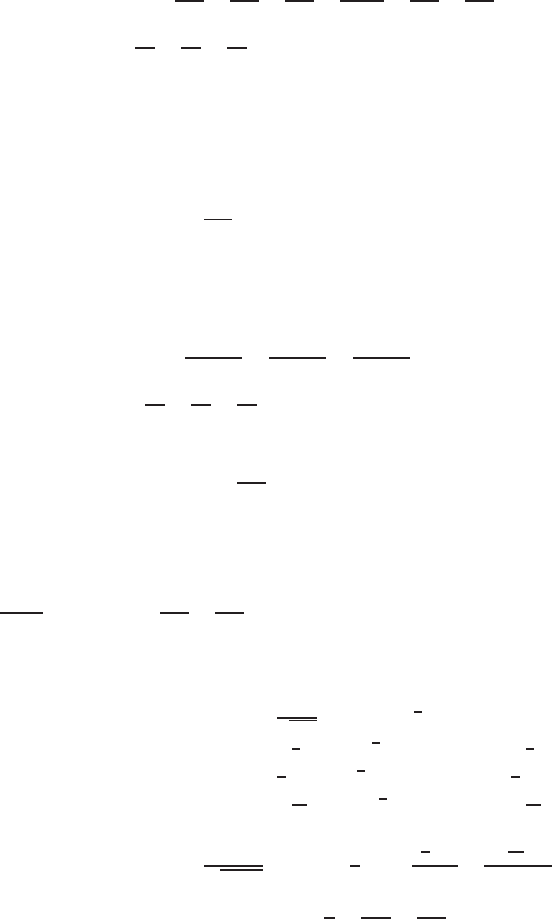
10.2 SOLUTIONS 943
3. Differentiating sin(−x):
f(x) = sin(−x)f(0) = 0,
f′(x) = cos(−x)(−1) = −cos(−x)f′(0) = −1,
f′′(x) = −(−sin(−x))(−1) = −sin(−x)f′′(0) = 0,
f′′′(x) = −cos(−x)(−1) = cos(−x)f′′′(0) = 1
f(4)(x) = −sin(−x)(−1) = sin(−x)f(4)(0) = 0,
f(5)(x) = cos(−x)(−1) = −cos(−x)f(5)(0) = −1,
f(6)(x) = −(−sin(−x))(−1) = −sin(−x)f(6)(0) = 0,
f(7)(x) = −cos(−x)(−1) = cos(−x)f(7)(0) = 1.
f(x) = sin(−x) = 0 −1·x+0x2
2! +1x3
3! +0x4
4! +−1x5
5! +0x6
6! +1x7
7! +···
=−x+x3
3! −x5
5! +x7
7! +···.
Notice that the series for sin(−x)is obtained from the series for sin xby changing the signs. This is expected since
sin(−x) = −sin x.
4. Differentiating ln(1 −x)
f(x) = ln(1 −x)f(0) = 0,
f′(x) = 1
1−x(−1) = −(1 −x)−1f′(0) = −1,
f′′(x) = −(−(1 −x)−2)(−1) = −(1 −x)−2f′′(0) = −1,
f′′′(x) = −2(−(1 −x)−3)(−1) = −2(1 −x)−3f′′′(0) = −2
f(4)(x) = −3(−2(1 −x)−4)(−1) = −6(1 −x)−4f(4)(0) = −6.
f(x) = ln(1 −x) = 0 −1·x+(−1)x2
2! +(−2)x3
3! +(−6)x4
4! +···
=−x−x2
2−x3
3−x4
4+···.
5.
f(x) = 1
1−x= (1 −x)−1f(0) = 1,
f′(x) = −(1 −x)−2(−1) = (1 −x)−2f′(0) = 1,
f′′(x) = −2(1 −x)−3(−1) = 2(1 −x)−3f′′(0) = 2,
f′′′(x) = −6(1 −x)−4(−1) = 6(1 −x)−4f′′′(0) = 6.
f(x) = 1
1−x= 1 + 1 ·x+2x2
2! +6x3
3! +···
= 1 + x+x2+x3+···
6.
f(x) = 1
√1+x= (1 + x)−1
2f(0) = 1
f′(x) = −1
2(1 + x)−3
2f′(0) = −1
2
f′′(x) = 3
4(1 + x)−5
2f′′(0) = 3
4
f′′′(x) = −15
8(1 + x)−7
2f′′′(0) = −15
8
f(x) = 1
√1 + x= 1 + −1
2x+(3
4)x2
2! +(−15
8)x3
3! +···
= 1 −x
2+3x2
8−5x3
16 +···
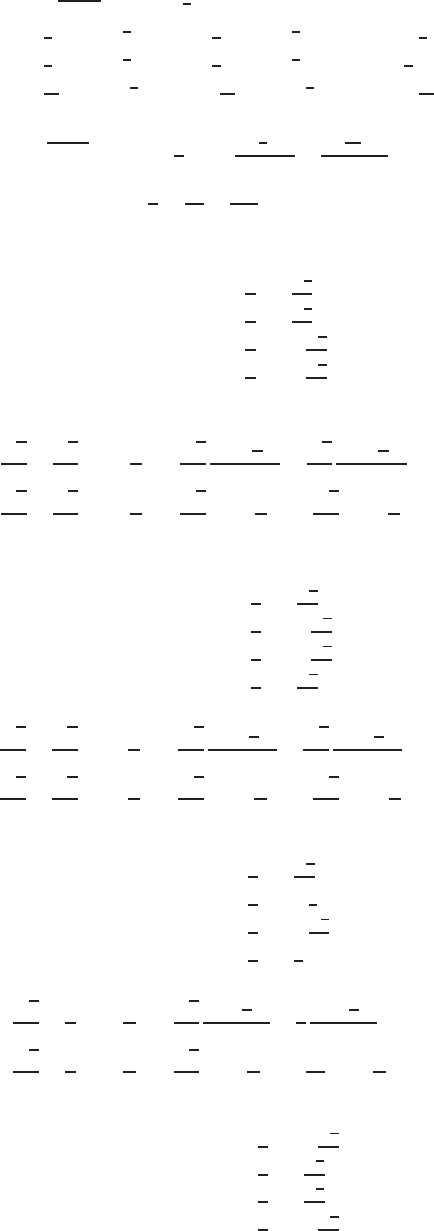
944 Chapter Ten /SOLUTIONS
7.
f(y) = 3
√1−y= (1 −y)1
3f(0) = 1
f′(y) = 1
3(1 −y)−2
3(−1) = −1
3(1 −y)−2
3f′(0) = −1
3
f′′(y) = 2
9(1 −y)−5
3(−1) = −2
9(1 −y)−5
3f′′(0) = 2
9
f′′′(y) = 10
27 (1 −y)−8
3(−1) = −10
27 (1 −y)−8
3f′′′(0) = −10
27
f(y) = 3
p1−y= 1 + −1
3y+(−2
9)y2
2! +(−10
27 )y3
3! +···
= 1 −y
3−y2
9−5y3
81 − ···
8.
f(x) = sin x f(π
4) = √2
2,
f′(x) = cos x f′(π
4) = √2
2,
f′′(x) = −sin x f′′(π
4) = −√2
2,
f′′′(x) = −cos x f′′′(π
4) = −√2
2.
sin x=√2
2+√2
2x−π
4−√2
2
(x−π
4)2
2! −√2
2
(x−π
4)3
3! − ···
=√2
2+√2
2x−π
4−√2
4x−π
42
−√2
12 x−π
43
− ···
9.
f(θ) = cos θ f(π
4) = √2
2,
f′(θ) = −sin θ f′(π
4) = −√2
2,
f′′(θ) = −cos θ f′′(π
4) = −√2
2,
f′′′(θ) = sin θ f′′′(π
4) = √2
2.
cos θ=√2
2−√2
2θ−π
4−√2
2
(θ−π
4)2
2! +√2
2
(θ−π
4)3
3! − ···
=√2
2−√2
2θ−π
4−√2
4θ−π
42
+√2
12 θ−π
43
− ···
10. Differentiating gives
f(t) = cos t f(π
6) = √3
2,
f′(t) = −sin t f′(π
6) = −1
2,
f′′(t) = −cos t f′′(π
6) = −√3
2,
f′′′(t) = sin t f′′′(π
6) = 1
2.
cos t=√3
2−1
2t−π
6−√3
2
(t−π
6)2
2! +1
2
(t−π
6)3
3! − ···
=√3
2−1
2t−π
6−√3
4t−π
62
+1
12 t−π
63
− ···
11.
f(θ) = sin θ f(−π
4) = −√2
2,
f′(θ) = cos θ f′(−π
4) = √2
2,
f′′(θ) = −sin θ f′′(−π
4) = √2
2,
f′′′(θ) = −cos θ f′′′(−π
4) = −√2
2.
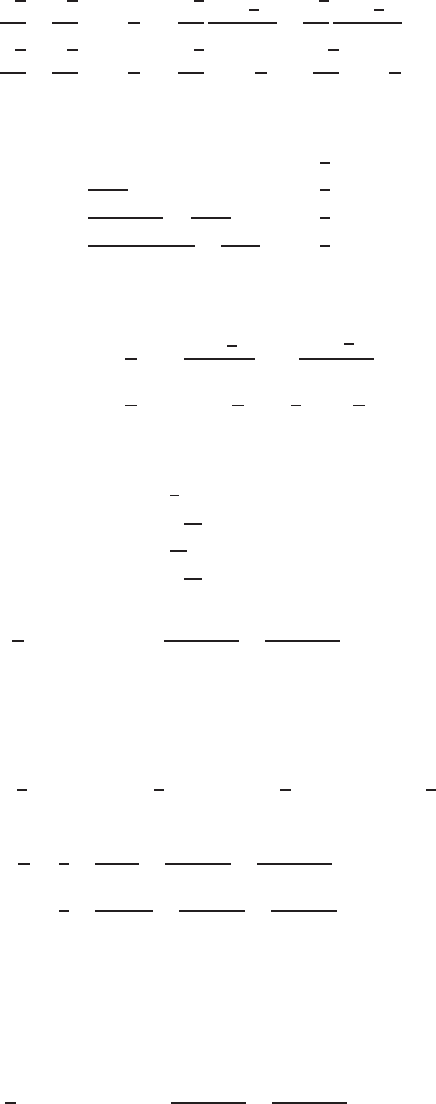
10.2 SOLUTIONS 945
sin θ=−√2
2+√2
2θ+π
4+√2
2
(θ+π
4)2
2! −√2
2
(θ+π
4)3
3! +···
=−√2
2+√2
2θ+π
4+√2
4θ+π
42
−√2
12 θ+π
43
+···.
12.
f(x) = tan x f (π
4) = 1,
f′(x) = 1
cos2xf′(π
4) = 2,
f′′(x) = −2(−sin x)
cos3x=2 sin x
cos3xf′′(π
4) = 4,
f′′′(x) = −6 sin x(−sin x)
cos4x+2
cos2xf′′′(π
4) = 16.
tan x= 1 + 2 x−π
4+ 4 (x−π
4)2
2! + 16 x−π
43
3! +···
= 1 + 2 x−π
4+ 2 x−π
42
+8
3x−π
43
+···
13.
f(x) = 1
xf(1) = 1
f′(x) = −1
x2f′(1) = −1
f′′(x) = 2
x3f′′(1) = 2
f′′′(x) = −6
x4f′′′(1) = −6
1
x= 1 −(x−1) + 2(x−1)2
2! −6(x−1)3
3! +···
= 1 −(x−1) + (x−1)2−(x−1)3+···.
14. Again using the derivatives found in Problem 13, we have
f(2) = 1
2, f′(2) = −1
4, f′′(2) = 1
4, f′′′(2) = −3
8.
1
x=1
2−x−2
4+(x−2)2
4·2! −3(x−2)3
8·3! +···
=1
2−(x−2)
4+(x−2)2
8−(x−2)3
16 +···
15. Using the derivatives from Problem 13, we have
f(−1) = −1, f′(−1) = −1, f′′(−1) = −2, f′′′(−1) = −6.
Hence,
1
x=−1−(x+ 1) −2(x+ 1)2
2! −6(x+ 1)3
3! − ···
=−1−(x+ 1) −(x+ 1)2−(x+ 1)3− ···
16. The general term can be written as xnfor n≥0.
17. The general term can be written as (−1)nxnfor n≥0.
18. The general term can be written as −xn/n for n≥1.
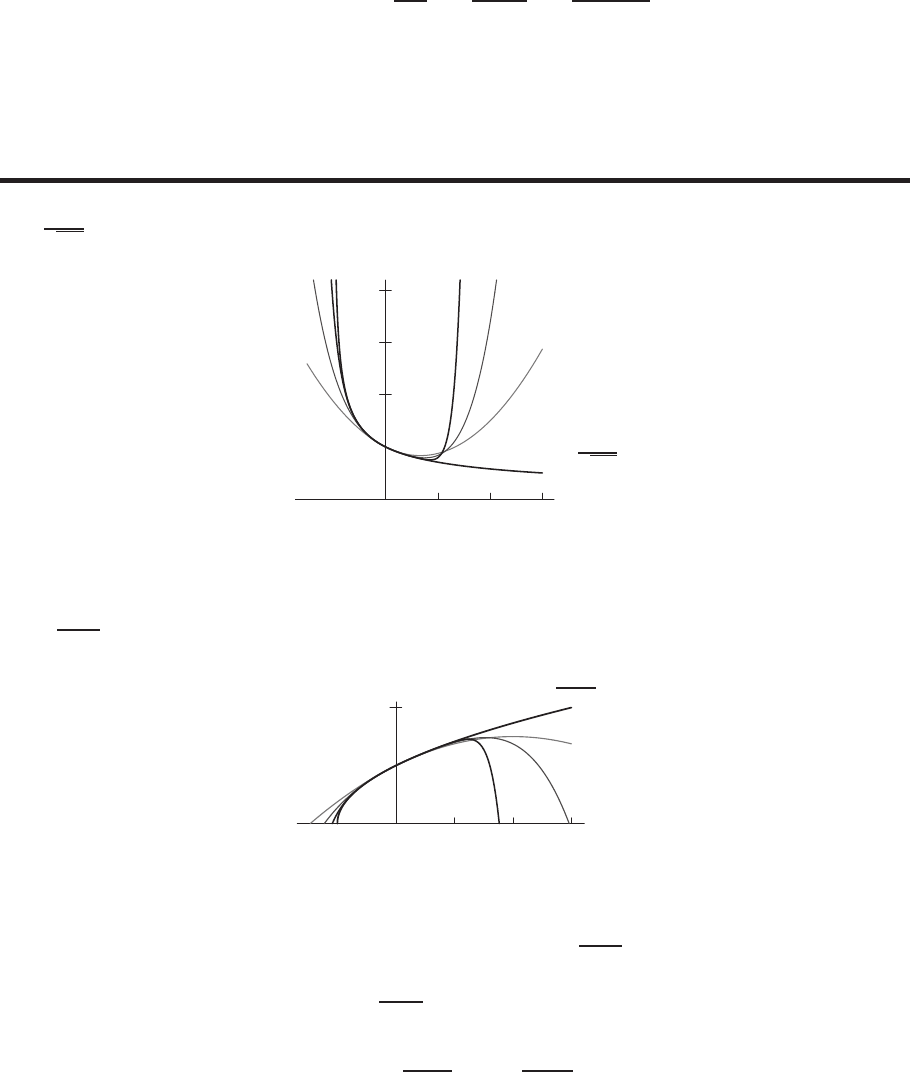
946 Chapter Ten /SOLUTIONS
19. The general term can be written as (−1)n−1xn/n for n≥1.
20. The general term can be written as (−1)kx2k+1/(2k+ 1)! for k≥0.
21. The general term can be written as (−1)kx2k+1/(2k+ 1) for k≥0.
22. The general term can be written as x2k/k!for k≥0.
23. The general term can be written as (−1)kx4k+2/(2k)! for k≥0.
24. The series is
(1 + x)3= 1 + 3x+3·2
2! x2+3·2·1
3! x3+3·2·1·0
4! x4+···.
The x4term and all terms beyond it turn out to be zero, because each coefficient contains a factor of 0. Simplifying gives
(1 + x)3= 1 + 3x+ 3x2+x3,
which is the usual expansion obtained by multiplying out (1 + x)3.
Problems
25. By looking at Figure 10.4 we can that the Taylor polynomials are reasonable approximations for the function f(x) =
1
√1+xbetween x=−1and x= 1. Thus a good guess is that the interval of convergence is −1< x < 1.
−1 1 2 3
1
2
3
4
f(x) = 1
√1+x
P2(x)
P4(x)P10(x)
x
Figure 10.4
26. By looking at Figure 10.5, we see that the Taylor polynomials are reasonable approximations for the function f(x) =
√1 + xbetween x=−1and x= 1. Thus a good guess is that the Taylor series converges to f(x)for −1< x < 1.
−1 1 2 3
1
2f(x) = √x+ 1
P2(x)
P4(x)
P10(x)
x
Figure 10.5
27. (a) Figure 10.6 suggests that the Taylor polynomials converge to f(x) = 1
1−xon the interval −1< x < 1.
(b) Since 1
1−x= 1 + x+x2+x3···.
the ratio test gives
lim
n→∞ |an+1|
|an|= lim
n→∞ |xn+1|
|xn|=|x|.
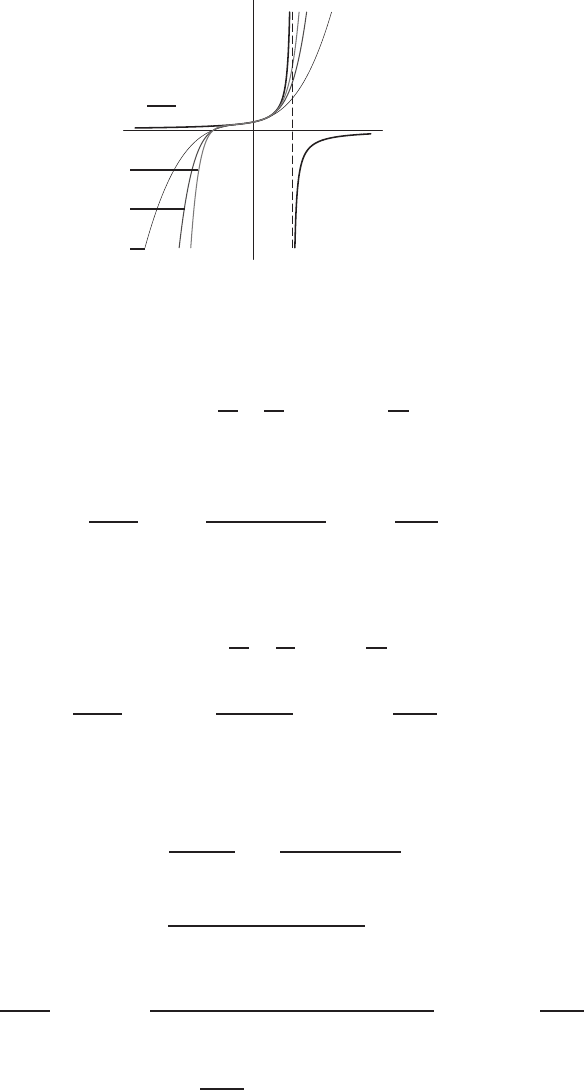
10.2 SOLUTIONS 947
Thus, the radius of convergence is R= 1. The series converges if |x|<1; that is, −1< x < 1.
✲
P3(x)
✲
P5(x)
✲
P7(x)
−11
f(x) = 1
1−x
x
Figure 10.6
28. The Taylor series of exaround x= 0 is
ex= 1 + x+x2
2! +x3
3! +···=∞
X
k=0
xk
k!.
To find the radius of convergence, we apply the ratio test with ak=xk/k!.
lim
k→∞ |ak+1|
|ak|= lim
k→∞ |x|k+1/(k+ 1)!
|x|k/k!= lim
k→∞ |x|
k+ 1 = 0.
Hence the radius of convergence is R=∞.
29. The Taylor series for ln(1 −x)is
ln(1 −x) = −x−x2
2−x3
3− ··· − xn
n− ·· ·,
so
lim
n→∞ |an+1|
|an|=|x|lim
n→∞
1/(n+ 1)
1/n =|x|lim
n→∞
n
n+ 1 =|x|.
Thus the series converges for |x|<1, and the radius of convergence is 1. Note: This series can be obtained from the series
for ln(1 + x)by replacing xby −xand has the same radius of convergence as the series for ln(1 + x).
30. (a) We have shown that the series is
1 + px +p(p−1)
2! x2+p(p−1)(p−2)
3! x3+···
so the general term is
p(p−1) . . . (p−(n−1))
n!xn.
(b) We use the ratio test
lim
n→∞ |an+1|
|an|=|x|lim
n→∞
p(p−1) ...(p−(n−1))(p−n)·n!
(n+ 1)!p(p−1) ...(p−(n−1)) =|x|lim
n→∞
p−n
n+ 1 .
Since pis fixed, we have
lim
n→∞
p−n
n+ 1 = 1,so R= 1.
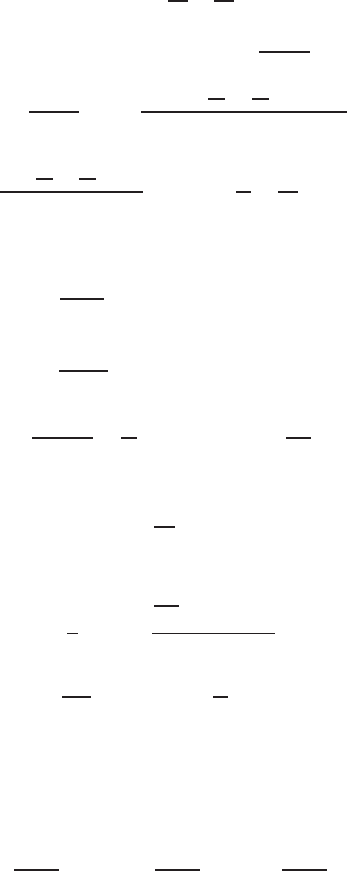
948 Chapter Ten /SOLUTIONS
31. We know that the Taylor series for exaround 0 is given by
ex= 1 + x+x2
2! +x3
3! +···.
Using the right hand side of the above equation for exin the expression ex−1
x, we have
lim
x→0
ex−1
x= lim
x→0
1 + x+x2
2! +x3
3! +··· − 1
x.
Simplifying we get
lim
x→0
x+x2
2! +x3
3! +···
x= lim
x→01 + x
2! +x2
3! +···= 1.
Hence this limit is equal to 1.
32. The second coefficient of the Taylor expansion is
g′′(0)
2= 1,so g′′(0) = 2.
Similarly, the third coefficient is
g′′′(0)
3! = 0 so g′′′(0) = 0.
Finally, the tenth coefficient is
g(10)(0)
10! =1
5! so g(10)(0) = 10!
5! .
33. Let Cnbe the coefficient of the nth term in the series. Note that
0 = C1=d
dx (x2ex2)x=0
,
and since
1
2=C6=
d6
dx6(x2ex2)x=0
6! ,
we have
d6
dx6(x2ex2)x=0
=6!
2= 360.
34. (a) From the coefficients of the (x−1) terms of the fs, we see that
f′
1(1) = 1, f′
2(1) = −1f′
3(1) = −2.
From the (x−1)2terms of the fs, we see that
f′′
1(1)
2! =−1,f′′
2(1)
2! = 1,f′′
3(1)
2! = 1,
so f′′
1(1) = −2,f′′
2(1) = 2,f′′
3(1) = 2.
Thus, f1slopes up at x= 1 and f2and f3slope down; f3slopes down more steeply than f2. This means that
the fs are in the first figure, since graphs II and III in the second figure have the same negative slope at point B.
By a similar argument, we find
g′
1(4) = −1, g′
2(4) = −1, g′
3(4) = 1,and g′′
1(4) = −2, g′′
2(4) = 2, g′′
3(4) = 2.
Thus, two of the gs slope down, one of which is concave up and one is concave down; the third gslopes up and is
concave up. This confirms that the gs are in the second figure.
(b) Since f1(1) = f2(1) = f3(1) = 3, the point Ais (1,3).
Since g1(4) = g2(4) = g3(4) = 5, the point Bis (4,5).
(c) In the first figure, graph I is f1since it slopes up. Graph II is f2since it slopes down, but less steeply than graph III,
which is f3.
In the second figure, graph I is g3, since it slopes up. Graph II is g2since it slopes down and is concave up.
Graph III is g1since it slopes down and is concave down.
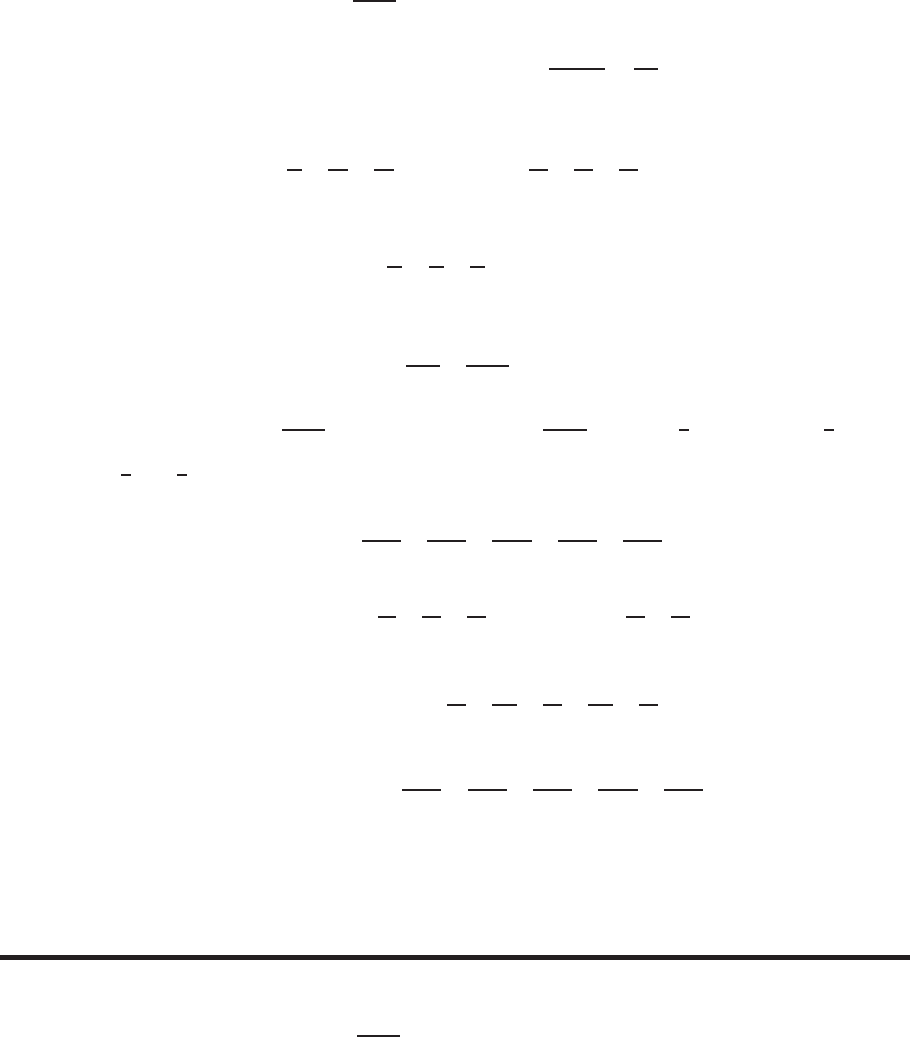
10.2 SOLUTIONS 949
35. This is the series for exwith xreplaced by 2, so the series converges to e2.
36. This is the series for sin xwith xreplaced by 1, so the series converges to sin 1.
37. This is the series for 1/(1 −x)with xreplaced by 1/4, so the series converges to 1/(1 −(1/4)) = 4/3.
38. This is the series for cos xwith xreplaced by 10, so the series converges to cos 10.
39. This is the series for ln(1 + x)with xreplaced by 1/2, so the series converges to ln(3/2).
40. The Taylor series for f(x) = 1/(1 + x)is
1
1 + x= 1 −x+x2−x3+···.
Substituting x= 0.1gives
1−0.1 + (0.1)2−(0.1)3+···=1
1 + 0.1=1
1.1.
Alternatively, this is a geometric series with a= 1,x=−0.1.
41. This is the series for exwith x= 3 substituted. Thus
1 + 3 + 9
2! +27
3! +81
4! +···= 1 + 3 + 32
2! +33
3! +34
4! +··· =e3.
42. This is the series for cos xwith x= 1 substituted. Thus
1−1
2! +1
4! −1
6! +···= cos 1.
43. This is the series for exwith −0.1substituted for x, so
1−0.1 + 0.01
2! −0.001
3! +··· =e−0.1.
44. Since 1 + x+x2+x3+···=1
1−x, a geometric series, we solve 1
1−x= 5 giving 1
5= 1 −x, so x=4
5.
45. Since x−1
2x2+1
3x3+···= ln(1 + x), we solve ln(1 + x) = 0.2, giving 1 + x=e0.2, so x=e0.2−1.
46. We define eiθ to be
eiθ = 1 + iθ +(iθ)2
2! +(iθ)3
3! +(iθ)4
4! +(iθ)5
5! +(iθ)6
6! +···
Suppose we consider the expression cos θ+isin θ, with cos θand sin θreplaced by their Taylor series:
cos θ+isin θ=1−θ2
2! +θ4
4! −θ6
6! +···+iθ−θ3
3! +θ5
5! − ···
Reordering terms, we have
cos θ+isin θ= 1 + iθ −θ2
2! −iθ3
3! +θ4
4! +iθ5
5! −θ6
6! − ···
Using the fact that i2=−1,i3=−i,i4= 1,i5=i, ···, we can rewrite the series as
cos θ+isin θ= 1 + iθ +(iθ)2
2! +(iθ)3
3! +(iθ)4
4! +(iθ)5
5! +(iθ)6
6! +···
Amazingly enough, this series is the Taylor series for exwith iθ substituted for x. Therefore, we have shown that
cos θ+isin θ=eiθ.
Strengthen Your Understanding
47. The left hand side of the equation is finite, namely −1, whereas the right hand side of the equation is infinite. The statement
is wrong, since
1
1−x= 1 + x+x2+x3+···
only for −1< x < 1.
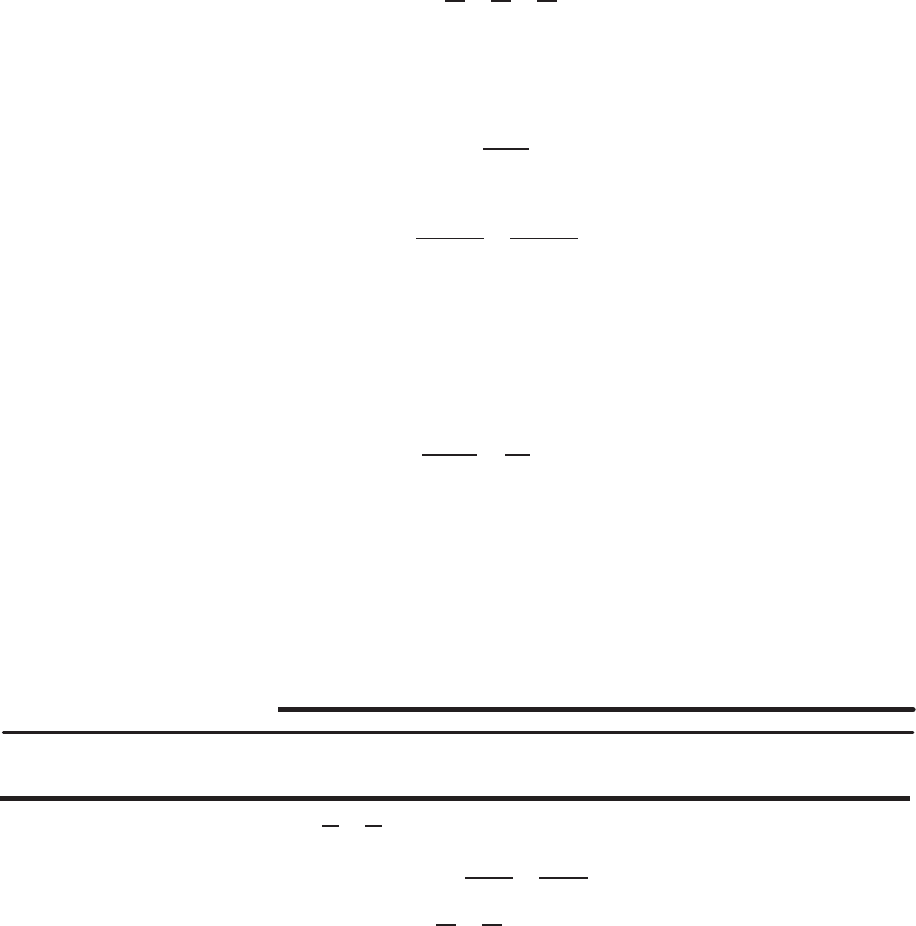
950 Chapter Ten /SOLUTIONS
48. First note that this Taylor series is convergent at 3. Substituting x= 4 into the series we get
1 + 1 + ···,
which is divergent, similarly substituting x= 2, we get the alternating geometric series
1 + (−1) + (−1)2+ (−1)3+···,
which is divergent. Since x= 3 is the center of the interval of convergence of the Taylor series, we see that the radius of
convergence cannot be greater or equal to 1.
49. The function f(x) = cos xis an example. The Taylor series for cos xis
cos x= 1 −x2
2! +x4
4! −x6
6! +···
The third-degree term of this series is zero.
50. A possible example is 1 + (x+ 1) + (x+ 1)2+. . .. Many other examples are possible.
51. False. The Taylor series for sin xabout x=πis calculated by taking derivatives and using the formula
f(a) + f′(a)(x−a) + f′′(a)
2! (x−a)2+···.
The series for sin xabout x=πturns out to be
−(x−π) + (x−π)3
3! −(x−π)5
5! +···.
52. True. Since fis even, f(−x) = f(x)for all x. Taking the derivative of both sides of this equation, we get f′(−x)(−1) =
f′(x), which at x= 0 gives −f′(0) = f′(0), so f′(0) = 0. Taking the derivative again gives f′′(−x) = f′′(x), i.e., f′′
is even. Using the same reasoning again, we get that f′′′(0) = 0, and, continuing in this way, we get f(n)(0) = 0 for all
odd n. Thus, for all odd n, the coefficient of xnin the Taylor series is f(n)(0)/n! = 0, so all the terms with odd exponent
are zero.
53. True. The coefficient of x7is −8/7!, so
f(7)(0)
7! =−8
7!
giving f(7)(0) = −8.
54. False. For example, the Taylor series
1 + x+x2+x3+···
for f(x) = 1/(1 −x)diverges for |x|>1, but 1/(1 −x)is defined for |x|>1.
55. True. For large x, the graph of P10(x)looks like the graph of its highest powered term, x10/10!. But exgrows faster than
any power, so exgets further and further away from x10/10! ≈P10(x).
Solutions for Section 10.3
Exercises
1. Substitute y=−xinto ey= 1 + y+y2
2! +y3
3! +···. We get
e−x= 1 + (−x) + (−x)2
2! +(−x)3
3! +···
= 1 −x+x2
2! −x3
3! +···.
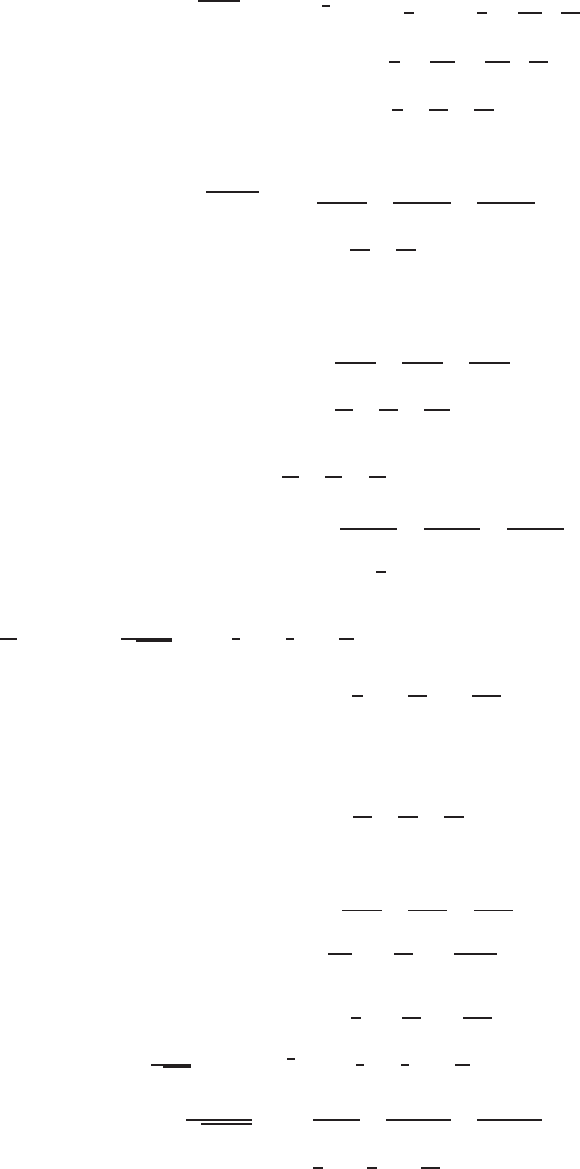
10.3 SOLUTIONS 951
2. We’ll use
p1 + y= (1 + y)1
2= 1 + 1
2y+1
2−1
2y2
2!
+1
2−1
2−3
2y3
3! +···
= 1 + y
2−y2
8+y3
16 − ···.
Substitute y=−2x.
√1−2x= 1 + (−2x)
2−(−2x)2
8+(−2x)3
16 − ···
= 1 −x−x2
2−x3
2− ···
3. Substitute x=θ2into series for cos x:
cos (θ2) = 1 −(θ2)2
2! +(θ2)4
4! −(θ2)6
6! +···
= 1 −θ4
2! +θ8
4! −θ12
6! +···.
4. Substituting x=−2yinto ln(1 + x) = x−x2
2+x3
3−x4
4+··· gives
ln(1 −2y) = (−2y)−(−2y)2
2+(−2y)3
3−(−2y)4
4+···
=−2y−2y2−8
3y3−4y4− ···.
5. Since d
dx (arcsin x) = 1
√1−x2= 1 + 1
2x2+3
8x4+5
16 x6+···, integrating gives
arcsin x=c+x+1
6x3+3
40 x5+5
112 x7+···.
Since arcsin 0 = 0,c= 0.
6. We substitute 3tinto the series for sin xand multiply by t. Since
sin x=x−x3
3! +x5
5! −x7
7! +···,
substituting 3tgives
sin(3t) = (3t)−(3t)3
3! +(3t)5
5! −(3t)7
7! +···
= 3t+−9
2t3+81
40 t5+−243
560 t7+···,
so
tsin(3t) = 3t2−9
2t4+81
40 t6−243
560 t8+···.
7. Substituting x=−z2into 1
√1+x= (1 + x)−1
2= 1 −1
2x+3
8x2−5
16 x3+··· gives
1
√1−z2= 1 −(−z2)
2+3(−z2)2
8−5(−z2)3
16 +···
= 1 + 1
2z2+3
8z4+5
16 z6+···.
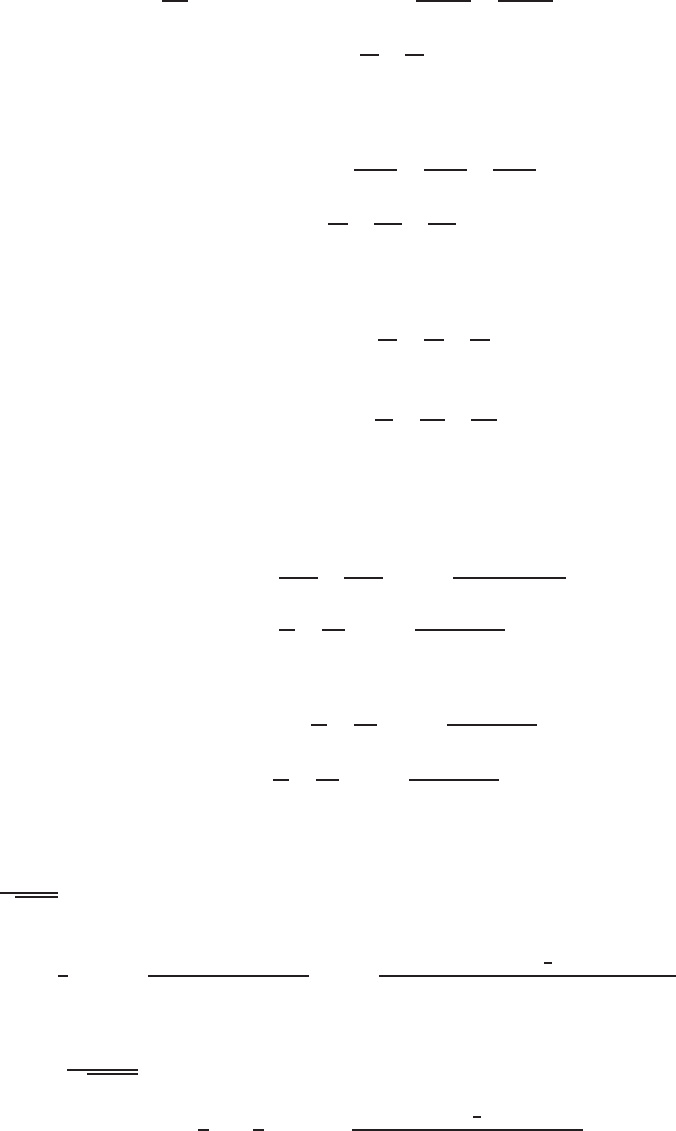
952 Chapter Ten /SOLUTIONS
8.
z
ez2=ze−z2=z1 + (−z2) + (−z2)2
2! +(−z2)3
3! +···
=z−z3+z5
2! −z7
3! +···
9.
φ3cos(φ2) = φ31−(φ2)2
2! +(φ2)4
4! −(φ2)6
6! +···
=φ3−φ7
2! +φ11
4! −φ15
6! +···
10. From Example 3, we know the Taylor series for arctan x:
arctan x=x−x3
3+x5
5−x7
7···.
Substituting x=r2, we get:
arctan(r2) = r2−r6
3+r10
5−r14
7+···.
11. Multiplying out gives (1 + x)3= 1 + 3x+ 3x2+x3. Since this polynomial equals the original function for all x, it must
be the Taylor series. The general term is 0·xnfor n≥4.
12. Substituting t2into the series for sin xgives
sin(t2) = t2−(t2)3
3! +(t2)5
5! +·· · +(−1)k(t2)2k+1
(2k+ 1)! +···
=t2−t6
3! +t10
5! +···+(−1)kt4k+2
(2k+ 1)! +···
Therefore
tsin(t2)−t3=t3−t7
3! +t11
5! +·· · +(−1)kt4k+3
(2k+ 1)! +···−t3
=−t7
3! +t11
5! +···+(−1)kt4k+3
(2k+ 1)! +··· for k≥1.
13. Using the Binomial theorem:
1
√1−x
= (1 −x)−1/2
= 1 + −1
2(−x) + (−1/2)(−3/2)(−x)2
2! +···+(−1/2)(−3/2) ···(−1
2−n+ 1)(−x)n
n!+··· for n≥1.
Substituting y2for x:
1
p1−y2= (1 −y2)−1/2
= 1 + 1
2y2+3
8y4+···+(1/2)(3/2) ···(1
2+n−1)y2n
n!+··· for n≥1.
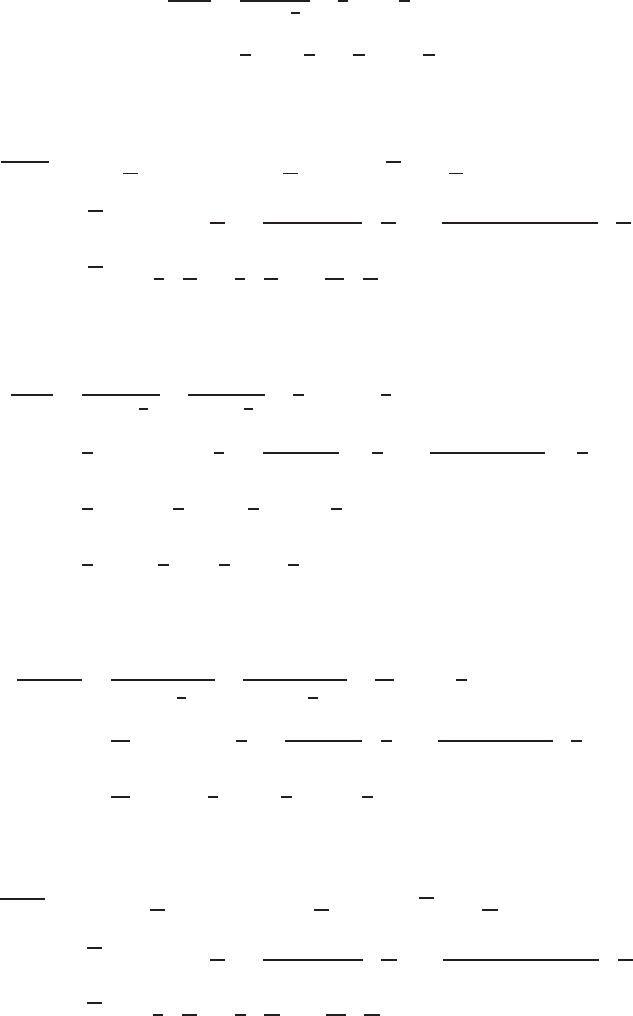
10.3 SOLUTIONS 953
14.
1
2 + x=1
2(1 + x
2)=1
21 + x
2−1
=1
21−x
2+x
22
−x
23
+···
15. Using the binomial expansion for (1 + x)1/2with x=h/T :
√T+h=T+T
Th1/2
=T1 + h
T1/2
=√T1 + h
T1/2
=√T1 + (1/2) h
T+(1/2)(−1/2)
2! h
T2
+(1/2)(−1/2)(−3/2)
3! h
T3
···
=√T1 + 1
2h
T−1
8h
T2
+1
16 h
T3
···.
16. Using the binomial expansion for (1 + x)−1with x=−r/a:
1
a−r=1
a−ar
a=1
a1−r
a=1
a1 + −r
a−1
=1
a1 + (−1) −r
a+(−1)(−2)
2! −r
a2
+(−1)(−2)(−3)
3! −r
a3
+···
=1
a1−−r
a+−r
a2
−−r
a3
+···
=1
a1 + r
a+r
a2
+r
a3
+···.
17. Using the binomial expansion for (1 + x)−2with x=r/a:
1
(a+r)2=1
a+ar
a2=1
a1 + r
a2=1
a21 + r
a−2
=1
a21 + (−2) r
a+(−2)(−3)
2! r
a2
+(−2)(−3)(−4)
3! r
a3
+···
=1
a21−2r
a+ 3 r
a2
−4r
a3
+···.
18.
3
√P+t=P+Pt
P1/3
=P1 + t
P1/3
=3
√P1 + t
P1/3
=3
√P1 + (1/3) t
P+(1/3)(−2/3)
2! t
P2
+(1/3)(−2/3)(−5/3)
3! t
P3
···
=3
√P1 + 1
3t
P−1
9t
P2
+5
81 t
P3
···.
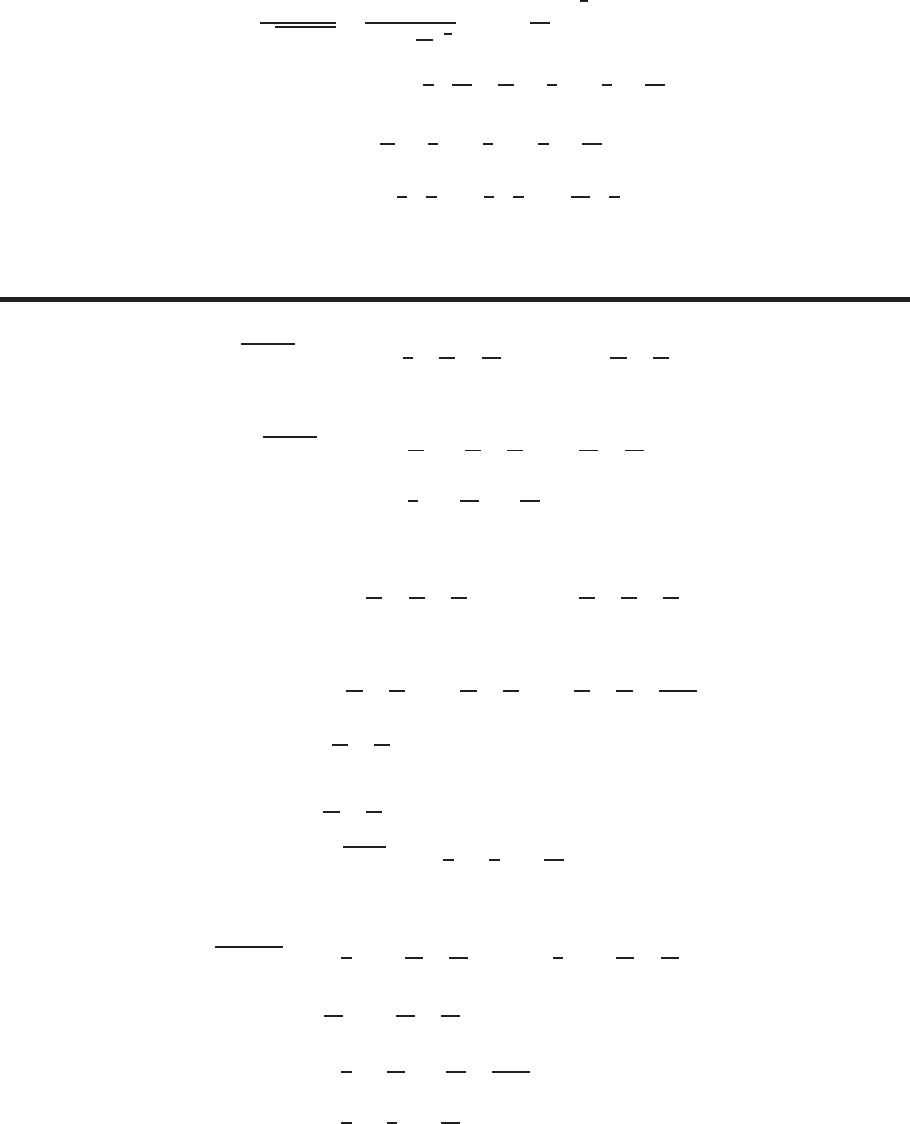
954 Chapter Ten /SOLUTIONS
19.
a
√a2+x2=a
a(1 + x2
a2)1
2
=1 + x2
a2−1
2
= 1 + −1
2x2
a2+1
2! −1
2−3
2x2
a22
+1
3! −1
2−3
2−5
2x2
a23
+···
= 1 −1
2x
a2
+3
8x
a4
−5
16 x
a6
+···
Problems
20.
p(1 + t) sin t=1 + t
2−t2
8+t3
16 − ···t−t3
3! +t5
5! − ···
Multiplying and collecting terms yields
p(1 + t) sin t=t+t2
2−t3
3! +t3
8+t4
16 −t4
12 +···
=t+1
2t2−7
24 t3−1
48 t4+···.
21.
etcos t=1 + t+t2
2! +t3
3! +t4
4! +···1−t2
2! +t4
4! −t6
6! +···
Multiplying out and collecting terms gives
etcos t= 1 + t+t2
2! −t2
2! +t3
3! −t3
2! +t4
4! +t4
4! −t4
(2!)2+···
= 1 + t−t3
3−t4
6+···.
22. Substituting the series for sin θ=θ−θ3
3! +θ5
5! − ··· into
p1 + y= 1 + 1
2y−1
8y2+1
16 y3− ···
gives
√1 + sin θ= 1 + 1
2θ−θ3
3! +θ5
5! − ···−1
8θ−θ3
3! +θ5
5! − ···2
+1
16 θ−θ3
3! +θ5
5! − ···3
− ···
= 1 + 1
2θ−θ2
8+θ3
16 −θ3
2·3! +···
= 1 + 1
2θ−1
8θ2−1
48 θ3+···
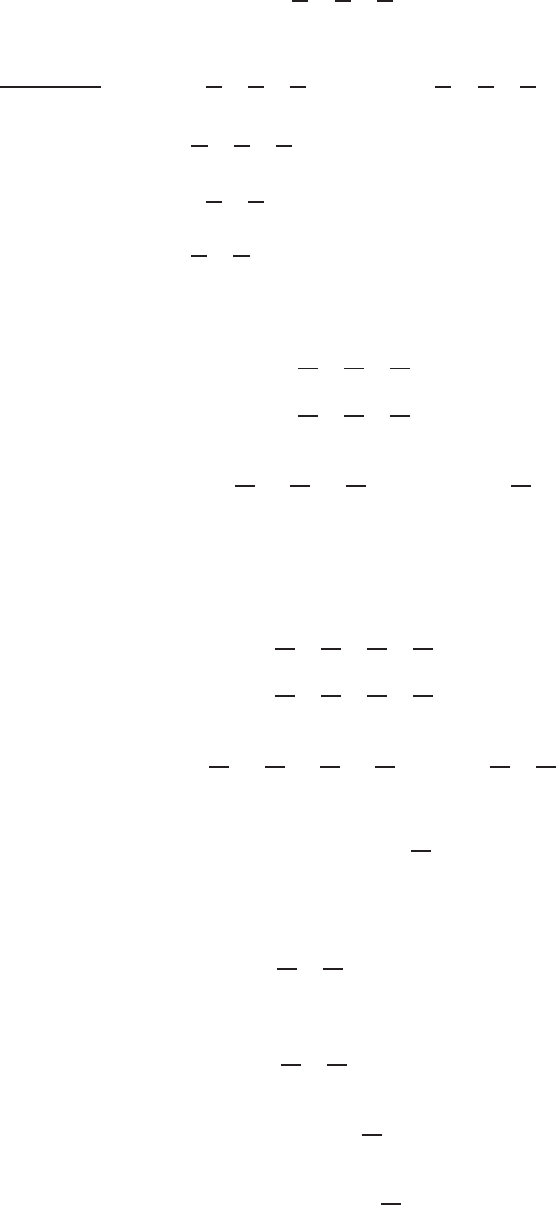
10.3 SOLUTIONS 955
23. We know that
ln(1 + t) = t−t2
2+t3
3−t4
4+···
So, treating the given function as the sum of a geometric series with initial term 1and common ratio ln(1 + t), we have
1
1−ln(1 + t)= 1 + t−t2
2+t3
3−t4
4+···+t−t2
2+t3
3−t4
4+···2
+t−t2
2+t3
3−t4
4+···3
+···
= 1 + t−t2
2+t3
3− ···+t2−t3+···+t3− ···+···
= 1 + t+t2
2+t3
3+···.
24. (a) Since the Taylor series for exand e−xare given by
ex= 1 + x+x2
2! +x3
3! +x4
4! +···
e−x= 1 −x+x2
2! −x3
3! +x4
4! +···,
we have
ex+e−x= 2 + 0x+ 2 x2
2! + 0 x3
3! + 2 x4
4! +···= 2 + x2+x4
12 +···.
(b) For xnear 0, we can approximate ex+e−xby its second degree Taylor polynomial, P2(x), whose graph is a parabola:
ex+e−x≈P2(x) = 2 + x2.
25. (a) Since the Taylor series for exand e−xare given by
ex= 1 + x+x2
2! +x3
3! +x4
4! +x5
5! +···
e−x= 1 −x+x2
2! −x3
3! +x4
4! −x5
5! +···,
we have
ex−e−x= 0 + 2x+ 0 x2
2! + 2 x3
3! + 0 x4
4! + 2 x5
5! ···= 2x+x3
3+x5
60 +···.
(b) For xnear 0, we can approximate ex−e−xby its third degree Taylor polynomial, P3(x):
ex−e−x≈P3(x) = 2x+x3
3.
The function P3(x)is a cubic polynomial whose graph is symmetric about the origin.
26. Recall that the Taylor series for exaround 0 is given by
1 + x+x2
2! +x3
3! +···.
Hence the Taylor series for ex2around 0 is then
1 + x2+x4
2! +x6
3! +···.
The first three terms are then
P4(x) = 1 + x2+x4
2! .
We approximate Z1
0
ex2dx ≈Z1
01 + x2+x4
2! dx.
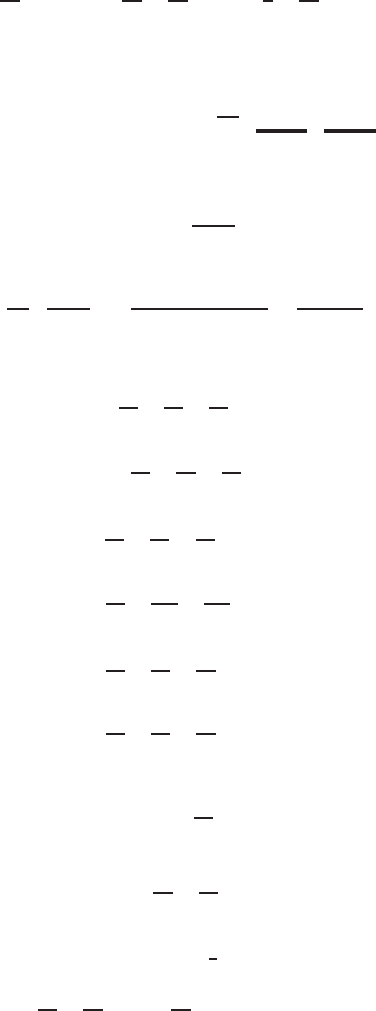
956 Chapter Ten /SOLUTIONS
Computing the integral
Z1
01 + x2+x4
2! dx =x+x3
3+x5
10
1
0
=1 + 1
3+1
10 ≈1.433.
27. Notice that Ppxp−1, is the derivative, term-by-term, of a geometric series:
∞
X
p=1
pxp−1= 1 ·x0+ 2 ·x1+ 3 ·x2+···=d
dx (x+x2+x3+···
| {z }
Geometric series
).
For |x|<1, the sum of the geometric series with first term xand common ratio xis
x+x2+x3+··· =x
1−x.
Differentiating gives
∞
X
p=1
pxp−1=d
dx x
1−x=1(1 −x)−x(−1)
(1 −x)2=1
(1 −x)2.
28. From the series for ln(1 + y),
ln(1 + y) = y−y2
2+y3
3−y4
4+···,
we get
ln(1 + y2) = y2−y4
2+y6
3−y8
4+···
The Taylor series for sin yis
sin y=y−y3
3! +y5
5! −y7
7! +···
So
sin y2=y2−y6
3! +y10
5! −y14
7! +···
The Taylor series for cos yis
cos y= 1 −y2
2! +y4
4! −y6
6! +···
So
1−cos y=y2
2! −y4
4! +y6
6! +···
Near y= 0,we can drop terms beyond the fourth degree in each expression:
ln(1 + y2)≈y2−y4
2
sin y2≈y2
1−cos y≈y2
2! −y4
4! .
(Note: These functions are all even, so what holds for negative ywill hold for positive y.)
Clearly 1−cos yis smallest, because the y2term has a factor of 1
2. Thus, for small y,
y2
2! −y4
4! < y2−y4
2< y2
so
1−cos y < ln(1 + y2)<sin(y2).
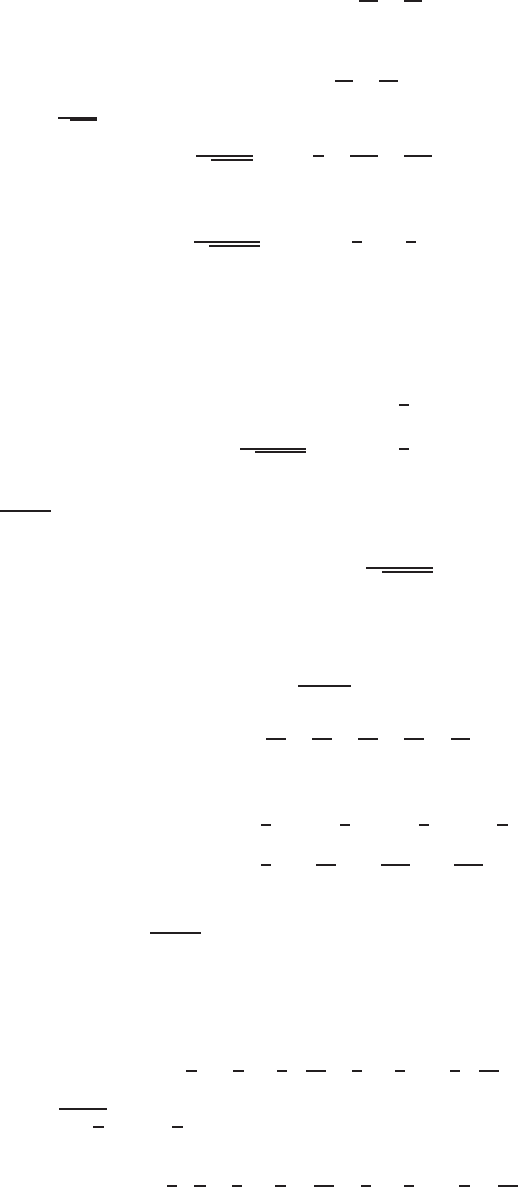
10.3 SOLUTIONS 957
29. The Taylor series for 1 + sin θnear θ= 0 is
1 + sin θ= 1 + θ−θ3
3! +θ5
5! − ···
The Taylor series for eθis
eθ= 1 + θ+θ2
2! +θ3
3! +···
The Taylor series for 1
√1+θis
1
√1 + θ= 1 −θ
2+3θ2
8−5θ3
16 +···
Substituting −2θinto this formula yields
1
√1−2θ= 1 + θ+3
2θ2+5
2θ3+···
These three series are identical in the constant and linear terms, but they differ in their quadratic terms. For values of
θnear zero, the quadratic terms dominate all of the subsequent terms, so we can use the approximations
1 + sin θ≈1 + θ
eθ≈1 + θ+1
2θ2
1
√1−2θ≈1 + θ+3
2θ2.
Clearly 1 + sin θis smallest, because the θ2term is zero, and the θ2terms of the other two series are positive. The
function 1/√1−2θis largest, because the coefficient of its θ2term is the greatest. Therefore, for θnear zero,
1 + sin θ≤eθ≤1
√1−2θ.
30. We have
P9(x) =
4
X
n=0
x2n+1
2n+ 1
=x1
1+x3
3+x5
5+x7
7+x9
9.
So,
P9(2x) = 2x+1
3(2x)3+1
5(2x)5+1
7(2x)7+1
9(2x)9
= 2x+8
3x3+32
5x5+128
7x7+512
9x9.
31. The Taylor series about 0 for y=1
1−x2is
y= 1 + x2+x4+x6+···.
The series for y= (1 + x)1/4is, using the binomial expansion,
y= 1 + 1
4x+1
4−3
4x2
2! +1
4−3
4−7
4x3
3! +···.
The series for y=q1 + x
2= (1 + x
2)1/2is, again using the binomial expansion,
y= 1 + 1
2·x
2+1
2−1
2·x2
8+1
2−1
2−3
2·x3
48 +···.
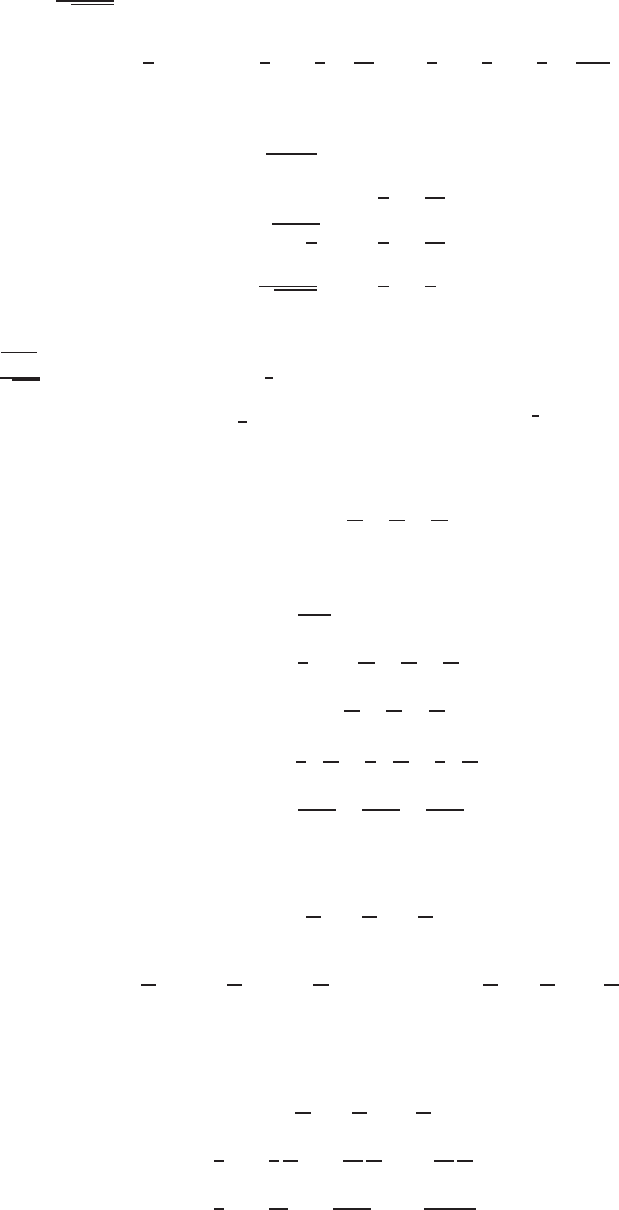
958 Chapter Ten /SOLUTIONS
Similarly for y=1
√1−x= (1 −x)−(1/2),
y= 1 + −1
2(−x) + −1
2−3
2·x2
2! +−1
2−3
2−5
2·−x3
3! +···.
Near 0, let’s truncate these series after their x2terms:
1
1−x2≈1 + x2,
(1 + x)1/4≈1 + 1
4x−3
32 x2,
q1 + x
2≈1 + 1
4x−1
32 x2,
1
√1−x≈1 + 1
2x+3
8x2.
Thus 1
1−x2looks like a parabola opening upward near the origin, with y-axis as the axis of symmetry, so (a) =I.
Now 1
√1−xhas the largest positive slope ( 1
2), and is concave up (because the coefficient of x2is positive). So (d) =
II.
The last two both have positive slope ( 1
4) and are concave down. Since (1 + x)1
4has the smallest second derivative
(i.e., the most negative coefficient of x2), (b) =IV and therefore (c) =III.
32. From the Taylor series for the sine function we know that
sin t≈t−t3
3! +t5
5! −t7
7! .
Thus, from the definition of Si(x), we have:
Si(2) = Z2
0
sin t
tdt
≈Z2
0
1
tt−t3
3! +t5
5! −t7
7! dt
=Z2
01−t2
3! +t4
5! −t6
7! dt
=t−1
3·t3
3! +1
5·t5
5! −1
7·t7
7!
2
0
= 2 −23
3·3! +25
5·5! −27
7·7!
= 1.60526.
This is very close to the actual value of Si(2) = 1.60541, found using a computer algebra system.
33. The Taylor series for sin tabout t= 0 is sin t=t−1
3! t3+1
5! t5−1
7! t7+···.This gives the Taylor series for sin t2
about t= 0:
sin t2=t2−1
3! t23+1
5! t25−1
7! t27+··· =t2−1
3! t6+1
5! t10 −1
7! t14 +···,
so
f(x) = Zx
0
sin t2dt
=Zx
0t2−1
3! t6+1
5! t10 −1
7! t14 +···dt
=1
3x3−1
7
1
3! x7+1
11
1
5! x11 −1
15
1
7! x15 +···
=1
3x3−1
42 x7+1
1320 x11 −1
75,600 x15 +···
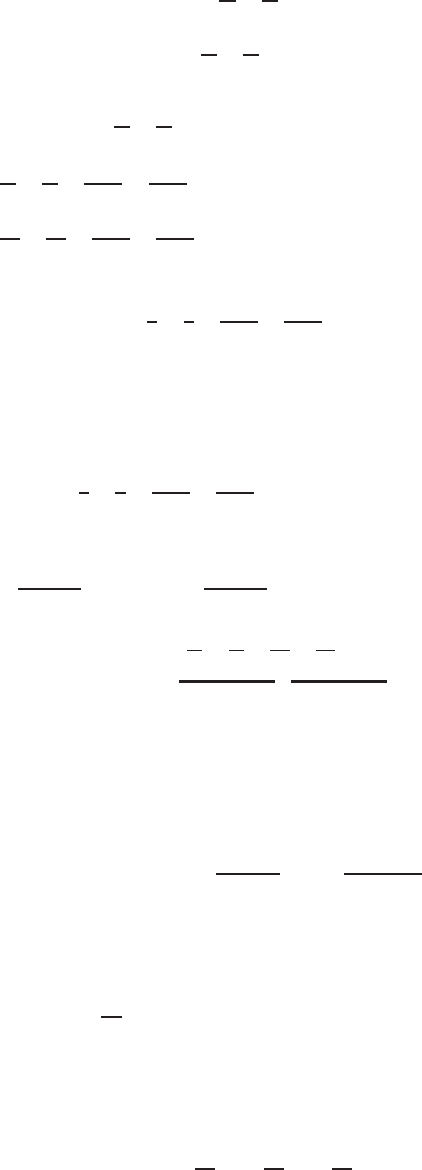
10.3 SOLUTIONS 959
34. (a) f(t) = tet.
Use the Taylor expansion for et:
f(t) = t1 + t+t2
2! +t3
3! +···
=t+t2+t3
2! +t4
3! +···
(b) Zx
0
f(t)dt =Zx
0
tetdt =Zx
0t+t2+t3
2! +t4
3! +···dt
=t2
2+t3
3+t4
4·2! +t5
5·3! +···
x
0
=x2
2+x3
3+x4
4·2! +x5
5·3! +···
(c) Substitute x= 1 : Z1
0
tetdt =1
2+1
3+1
4·2! +1
5·3! +···
In the integral above, to integrate by parts, let u=t, dv =etdt, so du =dt, v =et.
Z1
0
tetdt =tet
1
0−Z1
0
etdt =e−(e−1) = 1
Hence 1
2+1
3+1
4·2! +1
5·3! +··· = 1.
35. Since it does not depend on n, we can factor out e−k, giving
∞
X
n=1
kn−1
(n−1)! e−k=e−k∞
X
n=1
kn−1
(n−1)!
=e−k1
0! +k
1! +k2
2! +k3
3! +···
|{z }
This is the series for ek
=e−k·ek
= 1.
36. (a) The Taylor approximation to f(x) = cosh xabout x= 0 is of the form
cosh x≈cosh(0) + f′(0)x+f′′(0)x2
2! +... +f(n)(0)xn
n!.
We have the following results:
f(x) = cosh xso f(0) = 1,
f′(x) = sinh xso f′(0) = 0,
f′′(x) = d
dx (sinh x) = cosh xso f′′(0) = 1,
f′′′(x) = sinh xso f′′′(0) = 0.
The derivatives continue to alternate between cosh xand sinh x, so their values at 0 continue to alternate between 0
and 1. Therefore
cosh x≈1 + 0 ·x+ 1 ·x2
2! + 0 ·x3
3! + 1 ·x4
4! +···,
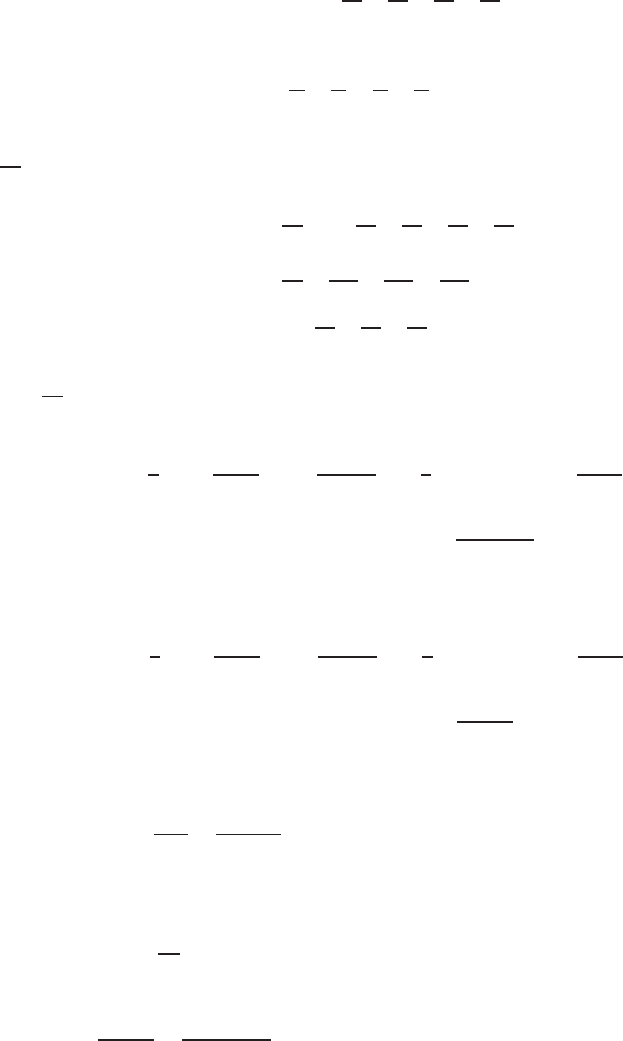
960 Chapter Ten /SOLUTIONS
so the degree 8 Taylor approximation is given by
cosh x≈1 + x2
2! +x4
4! +x6
6! +x8
8! .
(b) We use the polynomial obtained from part (a) to estimate cosh 1,
cosh 1 ≈1 + 1
2! +1
4! +1
6! +1
8! = 1.543080357.
Compared to the actual value of cosh 1 = 1.543080635 ..., the error is less than 10−6.
(c) Since d
dx (cosh x) = sinh x, we have
sinh x≈d
dx 1 + x2
2! +x4
4! +x6
6! +x8
8!
=2x
2! +4x3
4! +6x5
6! +8x7
8!
=x+x3
3! +x5
5! +x7
7! .
37. Since ex=∞
X
n=0
xn
n!and sinh 2x= (e2x−e−2x)/2, the Taylor expansion for sinh 2xis
sinh 2x=1
2 ∞
X
n=0
(2x)n
n!−∞
X
n=0
(−2x)n
n!!=1
2 ∞
X
n=0
(1 −(−1)n)(2x)n
n!!
=∞
X
m=0
(2x)2m+1
(2m+ 1)! .
Since cosh 2x= (e2x+e−2x)/2, we have
cosh 2x=1
2 ∞
X
n=0
(2x)n
n!+∞
X
n=0
(−2x)n
n!!=1
2 ∞
X
n=0
(1 + (−1)n)(2x)n
n!!
=∞
X
m=0
(2x)2m
(2m)! .
38. (a) The Taylor series for 1/(1 −x) = 1 + x+x2+x3+..., so
1
0.98 =1
1−0.02 = 1 + (0.02) + (0.02)2+ (0.02)3+...
= 1.020408 . . .
(b) Since d/dx(1/(1 −x)) = (1/(1 −x))2, the Taylor series for 1/(1 −x)2is
d
dx (1 + x+x2+x3+...) = 1 + 2x+ 3x2+ 4x3+···
Thus
1
(0.99)2=1
(1 −0.01)2= 1 + 2(0.01) + 3(0.0001) + 4(0.000001) + ···
= 1.0203040506 ...
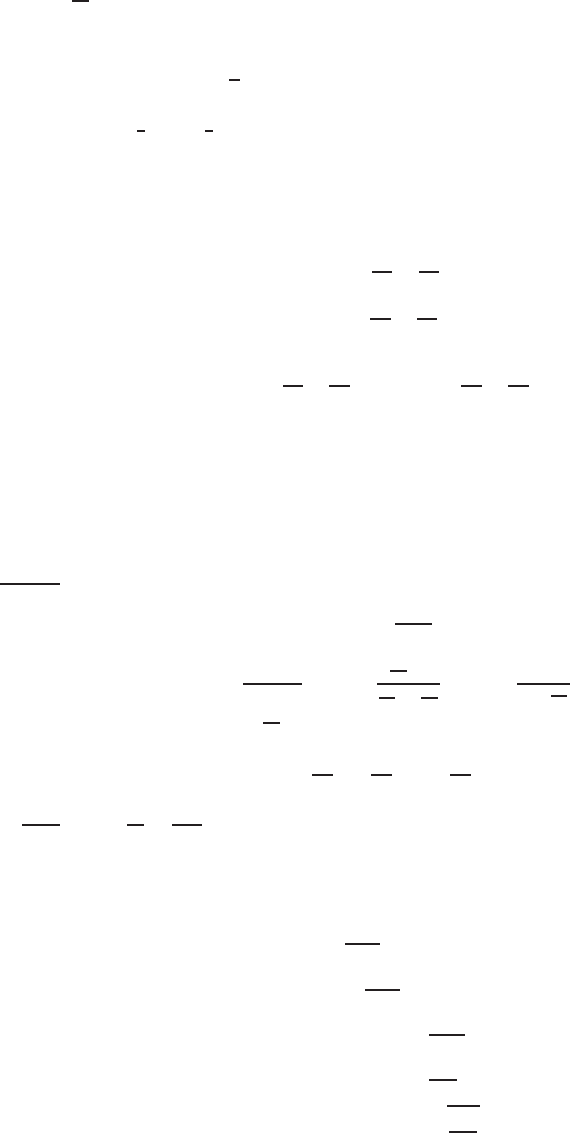
10.3 SOLUTIONS 961
39. (a) f(x) = (1 + ax)(1 + bx)−1= (1 + ax)1−bx + (bx)2−(bx)3+···
= 1 + (a−b)x+ (b2−ab)x2+···
(b) ex= 1 + x+x2
2+···
Equating coefficients:
a−b= 1,
b2−ab =1
2.
Solving gives a=1
2,b=−1
2.
40. (a) If φ= 0,
left side =b(1 + 1 + 1) = 3b≈0
so the equation is almost satisfied and there could be a solution near φ= 0.
(b) We have
sin φ=φ−φ3
3! +φ5
5! − ···
cos φ= 1 −φ2
2! +φ4
4! − ···
So
cos2φ=1−φ2
2! +φ4
4! − ···1−φ2
2! +φ4
4! − ···.
Neglecting terms of order φ2and higher, we get
sin φ≈φ
cos φ≈1
cos2φ≈1.
So φ+b(1 + 1 + 1) ≈0,whence φ≈ −3b.
41. (a) µ=mM
m+M.
If M >> m, then the denominator m+M≈M, so µ≈mM
M=m.
(b)
µ=mM
m+M=m1
MM
m
M+M
M=m1
1 + m
M
We can use the binomial expansion since m
M<1.
µ=m1−m
M+m
M2
−m
M3
+···
(c) If m≈1
1836 M, then m
M≈1
1836 ≈0.000545.
So a first order approximation to µwould give µ=m(1 −0.000545).The percentage difference from µ=mis
−0.0545%.
42. (a) Solving for ω0gives
ω0L−1
ω0C2
=0
ω0L−1
ω0C= 0
ω0L=1
ω0C
ω2
0=1
LC
ω0=r1
LC .
(Note: We discarded the negative root, because we need positive frequencies.)
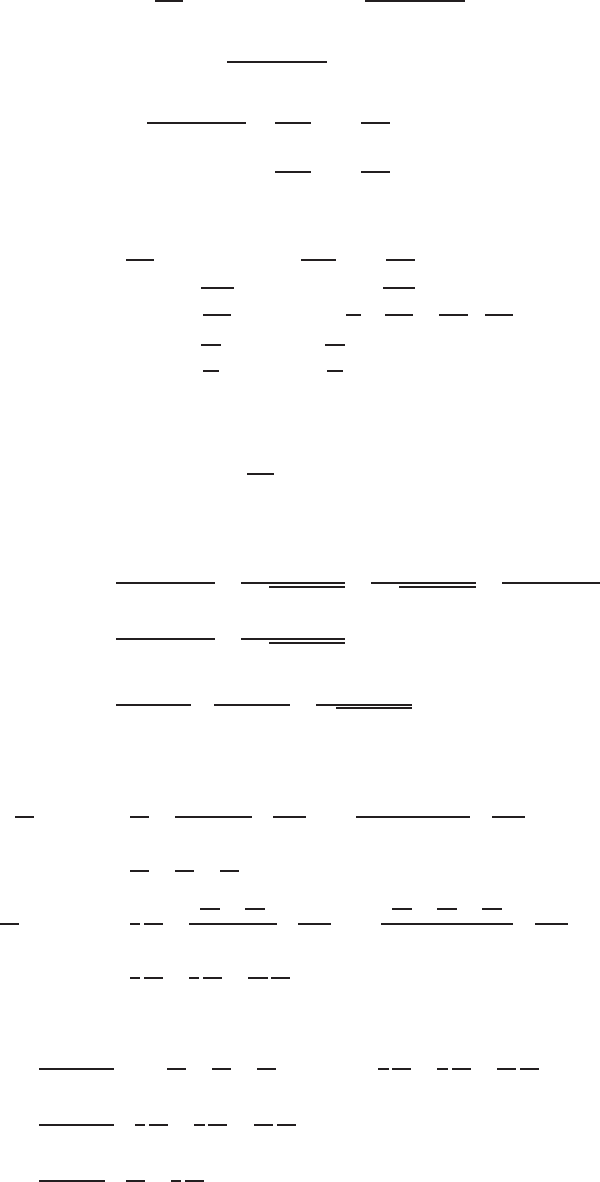
962 Chapter Ten /SOLUTIONS
(b) Set ω=ω0+ ∆ωand get
ωL −1
ωC 2
=(ω0+∆ω)L−1
(ω0+ ∆ω)C2
.
We need to find a Taylor expansion for the term 1
C(ω0+ ∆ω). Using the binomial expansion we have
1
C(ω0+ ∆ω)=1
Cω01 + ∆ω
ω0−1
=1
Cω01−∆ω
ω0
+···
Therefore,
ωL −1
ωC =ω0L+L∆ω−1
Cω01−∆ω
ω0
+···
=r1
LC ·L+L∆ω−1
CrLC
1+∆ω
C·LC
1
=rL
C+L∆ω−rL
C+L∆ω− ···
= 2L∆ω− ···.
So ωL −1
ωC 2
≈4L2(∆ω)2.
Notice that if ∆ω= 0 in the above expression, we get 0, which is what we expected, since in this case ω=ω0.
43. (a) Factoring the expression for t1−t2, we get
∆t=t1−t2=2l2
c(1 −v2/c2)−2l1
cp1−v2/c2−2l2
cp1−v2/c2+2l1
c(1 −v2/c2)
=2(l1+l2)
c(1 −v2/c2)−2(l1+l2)
cp1−v2/c2
=2(l1+l2)
c 1
1−v2/c2−1
p1−v2/c2!.
Expanding the two terms within the parentheses in terms of v2/c2gives
1−v2
c2−1
=1 + v2
c2+(−1)(−2)
2! −v2
c22
+(−1)(−2)(−3)
3! −v2
c23
+···
= 1 + v2
c2+v4
c4+v6
c6+···
1−v2
c2−1/2
= 1 + 1
2
v2
c2+−1
2−3
2
2! −v2
c22
+−1
2−3
2−5
2
3! −v2
c23
+···
= 1 + 1
2
v2
c2+3
8
v4
c4+5
16
v6
c6+···
Thus, we have
∆t=2(l1+l2)
c1 + v2
c2+v4
c4+v6
c6+··· − 1−1
2
v2
c2−3
8
v4
c4−5
16
v6
c6− ···
=2(l1+l2)
c1
2
v2
c2+5
8
v4
c4+11
16
v6
c6+···
∆t≈(l1+l2)
cv2
c2+5
4
v4
c4.
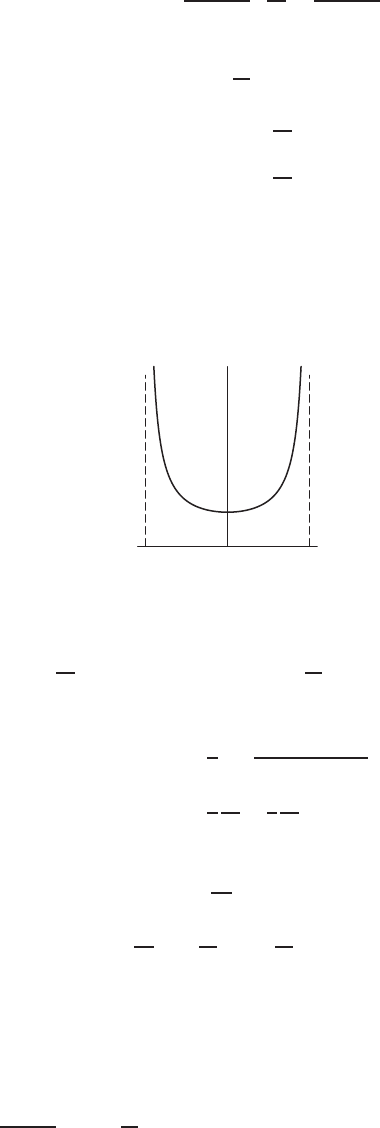
10.3 SOLUTIONS 963
(b) For small v. we can neglect all but the first nonzero term, so
∆t≈(l1+l2)
c·v2
c2=(l1+l2)
c3v2.
Thus, ∆tis proportional to v2with constant of proportionality (l1+l2)/c3.
44. (a) Since the expression under the square root sign, 1−v2
c2must be positive in order to give a real value of m, we have
1−v2
c2>0
v2
c2<1
v2< c2,
so −c < v < c.
In other words, the object can never travel faster that the speed of light.
(b) See Figure 10.7.
−cc
m0
v
m
Figure 10.7
(c) Notice that m=m01−v2
c2−1/2
.If we substitute u=−v2
c2, we get m=m0(1 + u)−1/2and we can use the
binomial expansion to get:
m=m01−1
2u+(−1/2)(−3/2)
2! u2+···
=m01 + 1
2
v2
c2+3
8
v4
c4+···.
(d) We would expect this series to converge only for values of the original function that exist, namely when |v|< c.
45. (a) To find when Vtakes on its minimum values, set dV
dr = 0. So
−V0d
dr 2r0
r6
−r0
r12= 0
−V0−12r6
0r−7+ 12r12
0r−13= 0
12r6
0r−7= 12r12
0r−13
r6
0=r6
r=r0.
Rewriting V′(r)as 12r6
0V0
r71−r0
r6,we see that V′(r)>0for r > r0and V′(r)<0for r < r0. Thus,
V=−V0(2(1)6−(1)12) = −V0is a minimum.
(Note: We discard the negative root −r0since the distance rmust be positive.)
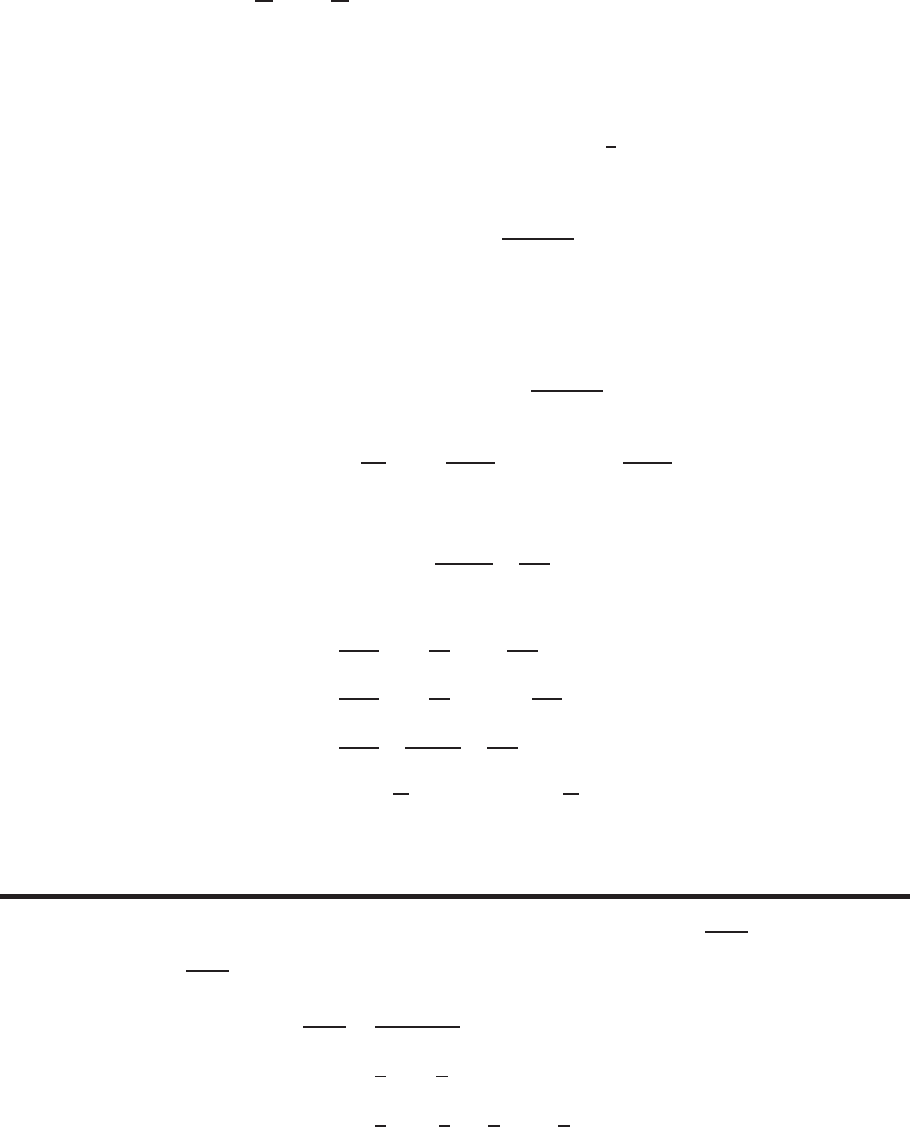
964 Chapter Ten /SOLUTIONS
(b)
V(r) = −V02r0
r6
−r0
r12
V′(r) = −V0(−12r6
0r−7+ 12r12
0r−13)
V′′(r) = −V0(84r6
0r−8−156r12
0r−14)
V(r0) = −V0
V′(r0) = 0
V′′(r0) = 72V0r−2
0
The Taylor series is thus:
V(r) = −V0+ 72V0r−2
0·(r−r0)2·1
2+···
(c) The difference between Vand its minimum value −V0is
V−(−V0) = 36V0
(r−r0)2
r2
0
+···
which is approximately proportional to (r−r0)2since terms containing higher powers of (r−r0)have relatively
small values for rnear r0.
(d) From part (a) we know that dV/dr = 0 when r=r0, hence F= 0 when r=r0. Since, if we discard powers of
(r−r0)higher than the second,
V(r)≈ −V01−36(r−r0)2
r2
0
giving
F=−dV
dr ≈72 ·r−r0
r2
0
(−V0) = −72V0
r−r0
r2
o
.
So Fis approximately proportional to (r−r0).
46. Solving for Pgives
P=nRT
V−nb −n2a
V2.
Expanding Pin terms of 1/V gives
P=nRT
V1−nb
V−1
−n2a
V2
P=nRT
V1 + nb
V+···−n2a
V2
P=nRT
V+n2bRT
V2−n2a
V2
P=nRT 1
V+n2(bRT −a)1
V2
+···.
Strengthen Your Understanding
47. By substituting x= 0, we get 1/2 = 1. So this equation is not correct. The Taylor series for 1
2 + xcan be obtained using
the Taylor series of 1
1 + xand writing
1
2 + x=1
2(1 + x/2)
=1
21 + x
2−1
=1
21−x
2+x
22
−x
23
+···
Hence the equation given is missing a factor of 1/2on the right.
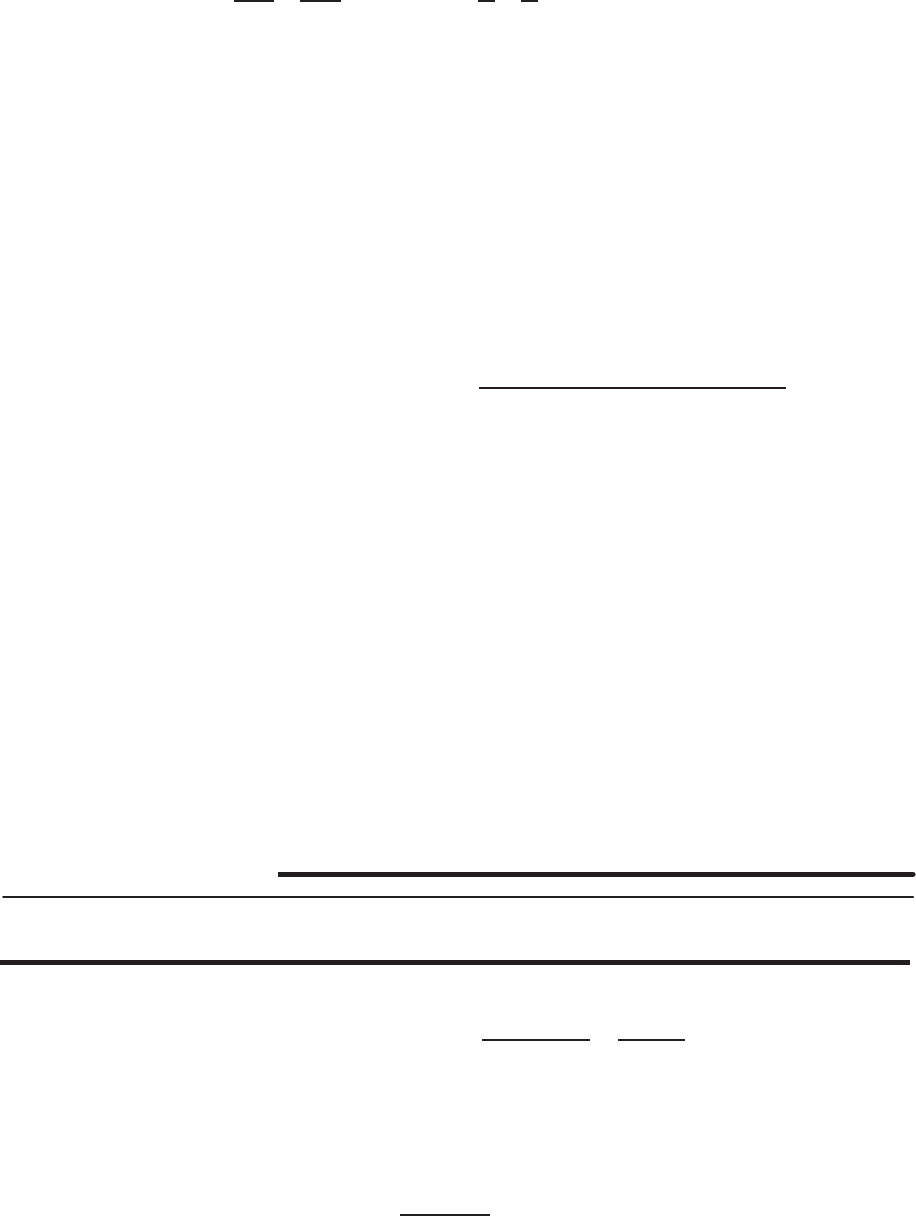
10.4 SOLUTIONS 965
48. The order of operations has not been respected. In e−xthe function exis composed with the function −x. Therefore we
have: e−x= 1 + (−x) + (−x)2
2! +(−x)3
3! +···= 1 −x+x2
2! −x3
3! +···.
49. If a function or some of its derivatives are not defined at x= 0 then we cannot write a Taylor series for that function. An
example is ln x. Many other examples are possible.
50. An example is f(x) = |x|. The function |x|is not differentiable at x= 0, hence we cannot write its Taylor series around
0. Many other examples are possible.
51. True. Since the derivative of a sum is the sum of the derivatives, Taylor series add.
52. True. Since the Taylor series for cos xhas only even powers, multiplying by x3gives only odd powers.
53. False. The derivative of f(x)g(x)is not f′(x)g′(x). If this statement were true, the Taylor series for (cos x)(sin x)would
have all zero terms.
54. True. We have
L1(x) + L2(x) = (f1(0) + f′
1(0)x) + (f2(0) + f′
2(0)x) = (f1(0) + f2(0)) + (f′
1(0) + f′
2(0))x.
The right hand side is the linear approximation to f1+f2near x= 0.
55. False. The quadratic approximation to f1(x)f2(x)near x= 0 is
f1(0)f2(0) + (f′
1(0)f2(0) + f1(0)f′
2(0))x+f′′
1(0)f2(0) + 2f′
1(0)f′
2(0) + f1(0)f′′
2(0)
2x2.
On the other hand, we have
L1(x) = f1(0) + f′
1(0)x, L2(x) = f2(0) + f′
2(0)x,
so
L1(x)L2(x) = (f1(0) + f′
1(0)x)(f2(0) + f′
2(0)x) = f1(0)f2(0) + (f′
1(0)f2(0) + f′
2(0)f1(0))x+f′
1(0)f′
2(0)x2.
The first two terms of the right side agree with the quadratic approximation to f1(x)f2(x)near x= 0, but the term of
degree 2 does not.
For example, the linear approximation to exis 1+x, but the quadratic approximation to (ex)2=e2xis 1+2x+2x2,
not (1 + x)2= 1 + 2x+x2.
56. (a) ln(4 −x) = ln(4(1 −x/4)) = ln(4) + ln(1 −x/4), so the Taylor series converges for −1< x/4<1, or
−4< x < 4. The radius of convergence is 4.
(b) ln(4 + x) = ln(4(1 −(−x/4))) = ln(4) + ln(1 −(−x/4)), so the Taylor series converges for −1<−x/4<1,
or 4> x > −4. The radius convergence is 4.
(c) ln(1 + 4x2) = ln(1 −(−4x2)), so the Taylor series converges for −1<−4x2<1. This gives x2<1/4, or
−1/2< x < 1/2. The radius of convergence is 1/2.
57. (c). The Taylor series for 3 tan(x/3) = 3(x/3 + (x/3)3/3 + 21(x/3)5/120 + ···) = x+x2/27 + 7x5/3240 + ···
Solutions for Section 10.4
Exercises
1. The error bound in approximating e01 using the Taylor polynomial of degree 3 for f(x) = exabout x= 0 is:
|E3|=|f(0.1) −P3(0.1)| ≤ M· |0.1−0|4
4! =M(0.1)4
24 ,
where |f(4)(x)| ≤ Mfor 0≤x≤0.1. Now, f(4)(x) = ex. Since exis increasing for all x, we see that |f(4) (x)|is
maximized for xbetween 0and 0.1when x= 0.1. Thus,
|f(4)| ≤ e0.1,
so
|E3| ≤ e0.1·(0.1)4
24 = 0.00000460.
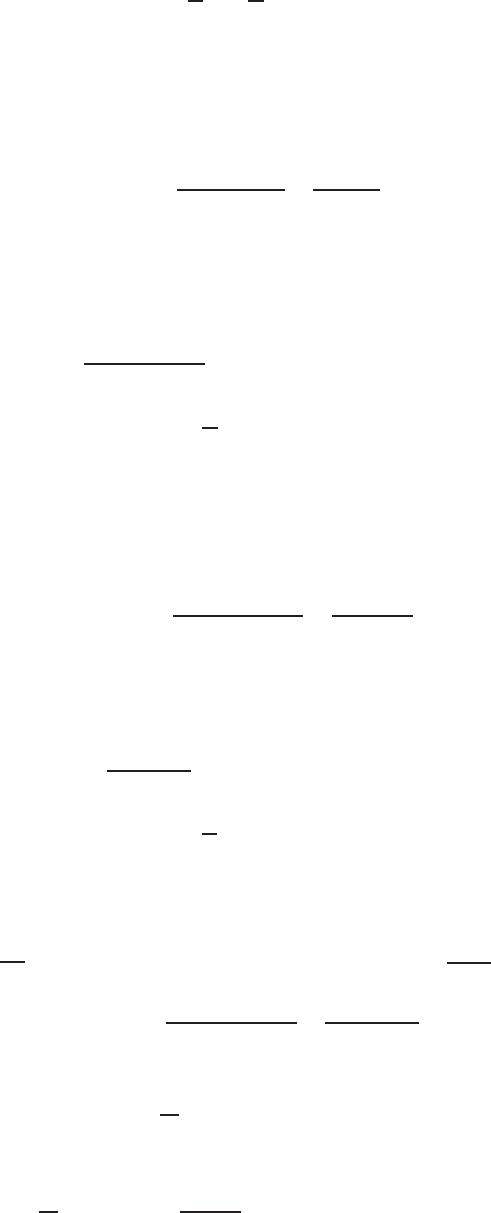
966 Chapter Ten /SOLUTIONS
The Taylor polynomial of degree 3is
P3(x) = 1 + x+1
2! x2+1
3! x3.
The approximation is P3(0.1), so the actual error is
E3=e0.1−P3(0.1) = 1.10517092 −1.10516667 = 0.00000425,
which is slightly less than the bound.
2. The error bound in approximating sin(0.2) using the Taylor polynomial of degree 3 for f(x) = sin xabout x= 0 is:
|E3|=|f(0.2) −P3(0.2)| ≤ M· |0.2−0|4
4! =M(0.2)4
24 ,
where |f(4)(x)| ≤ Mfor 0≤x≤0.2. Now, f(4)(x) = sin x. By looking at the graph of sin x, we see that |f(4)(x)|is
maximized for xbetween 0and 0.2when x= 0.2. Thus,
|f(4)| ≤ sin(0.2),
so
|E3| ≤ sin(0.2) ·(0.2)4
24 = 0.0000132.
The Taylor polynomial of degree 3is
P3(x) = x−1
3! x3.
The approximation is P3(0.1), so the actual error is
E3= sin(0.2) −P3(0.2) = 0.19866933 −0.19866667 = 0.00000266,
which is much less than the bound.
3. The error bound in approximating cos(−0.3) using the Taylor polynomial of degree 3 for f(x) = cos xabout x= 0 is:
|E3|=|f(−0.3) −P3(−0.3)| ≤ M· | − 0.3−0|4
4! =M(−0.3)4
24 ,
where |f(4)(x)| ≤ Mfor 0≥x≥ −0.3. Now, f(4)(x) = cos x, which has its largest value of 1 at x= 0. Thus,
|f(4)| ≤ cos 0 = 1,
so
|E3| ≤ 1·(−0.3)4
24 = 0.000338.
The Taylor polynomial of degree 3is
P3(x) = 1 −1
2! x2.
The approximation is P3(−0.3), so the actual error is
E3= cos(−0.3) −P(−0.3) = 0.955336 −0.955000 = 0.000336,
which is slightly less than the bound.
4. The error bound in approximating √0.9using the Taylor polynomial of degree three for f(x) = √1 + xabout x= 0 is:
|E3|=|f(−0.1) −P3(−0.1)| ≤ M· | − 0.1−0|4
4! =M·(−0.1)4
24 ,
where |f(4)| ≤ Mfor 0≥x≥ −0.1.Since
f(4)(x) = −15
16 (1 + x)−7/2,
we see that if xis between 0and −0.1, the maximum is at x=−0.1. Thus |f(4)x)| ≤ (15/16)(1 −0.1)−7/2, so
|E3| ≤ 15
16 (1 −0.1)−7/2·(−0.1)4
24 = 0.00000565.
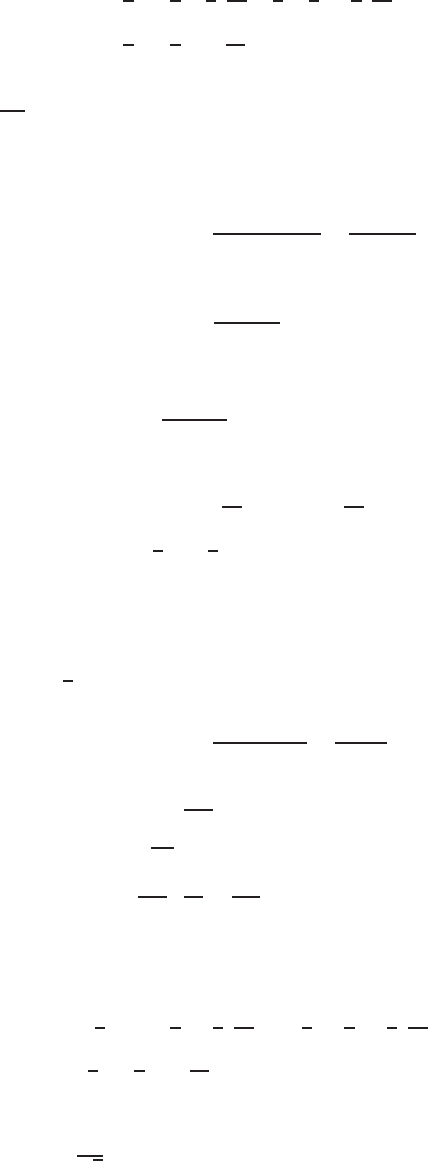
10.4 SOLUTIONS 967
The Taylor polynomial of degree 3is
P3(x) = 1 + 1
2x+1
2(−1
2)x2
2! +1
2(−1
2)(−3
2)x3
3!
= 1 + 1
2x−1
8x2+1
16 x3.
The approximation is P3(−0.1), so the actual error is
E3=√0.9−P3(−0.1) = 0.94868330 −0.94868750 = −0.00000420,
which is slightly less, in absolute value, than the bound.
5. The error bound in approximating ln(1.5) using the Taylor polynomial of degree 3 for f(x) = ln(1 + x)about x= 0 is:
|E4|=|f(0.5) −P3(0.5)| ≤ M· |0.5−0|4
4! =M(0.5)4
24 ,
where |f(4)(x)| ≤ Mfor 0≤x≤0.5.Since
f(4)(x) = −3!
(1 + x)4
and the denominator attains its minimum when x= 0, we have |f(4)(x)| ≤ 3!,so
|E4| ≤ 3! (0.5)4
24 = 0.0156.
The Taylor polynomial of degree 3is
P3(x) = 0 + x+ (−1) x2
2! + (−1)(−2) x3
3!
=x−1
2x2+1
3x3.
The approximation is P3(0.5), so the actual error is
E3= ln(1.5) −P3(0.5) = 0.4055 −0.4167 = −0.0112
which is slightly less, in absolute value, than the bound.
6. The error bound in approximating 1/√3using the Taylor polynomial of degree three for f(x) = (1 + x)−1/2about
x= 0 is:
|E3|=|f(2) −P3(2)| ≤ M· |2−0|4
4! =M·24
24 ,
where |f(4)| ≤ Mfor 0≤x≤2.Since
f(4)(x) = 105
16 (1 + x)−9/2,
we see that if xis between 0and 2, then |f(4)x)| ≤ 105
16 . Thus,
|E3| ≤ 105
16 ·24
24 =105
24 = 4.375.
This is not a very helpful bound on the error, but that is to be expected as the Taylor series does not converge at x= 2.
(At x= 2, we are outside the interval of convergence.)
The Taylor polynomial of degree 3is
P3(x) = 1 + ( 1
2)x+ (−1
2)(−3
2)x2
2! + (−1
2)(−3
2)(−5
2)x3
3!
= 1 −1
2x+3
8x2−5
16 x3.
The approximation is P3(2), so the actual error is
E3=1
√3−P3(2) = 0.577 −(−1.0) = 1.577,
which is much less than the bound, but still very large.
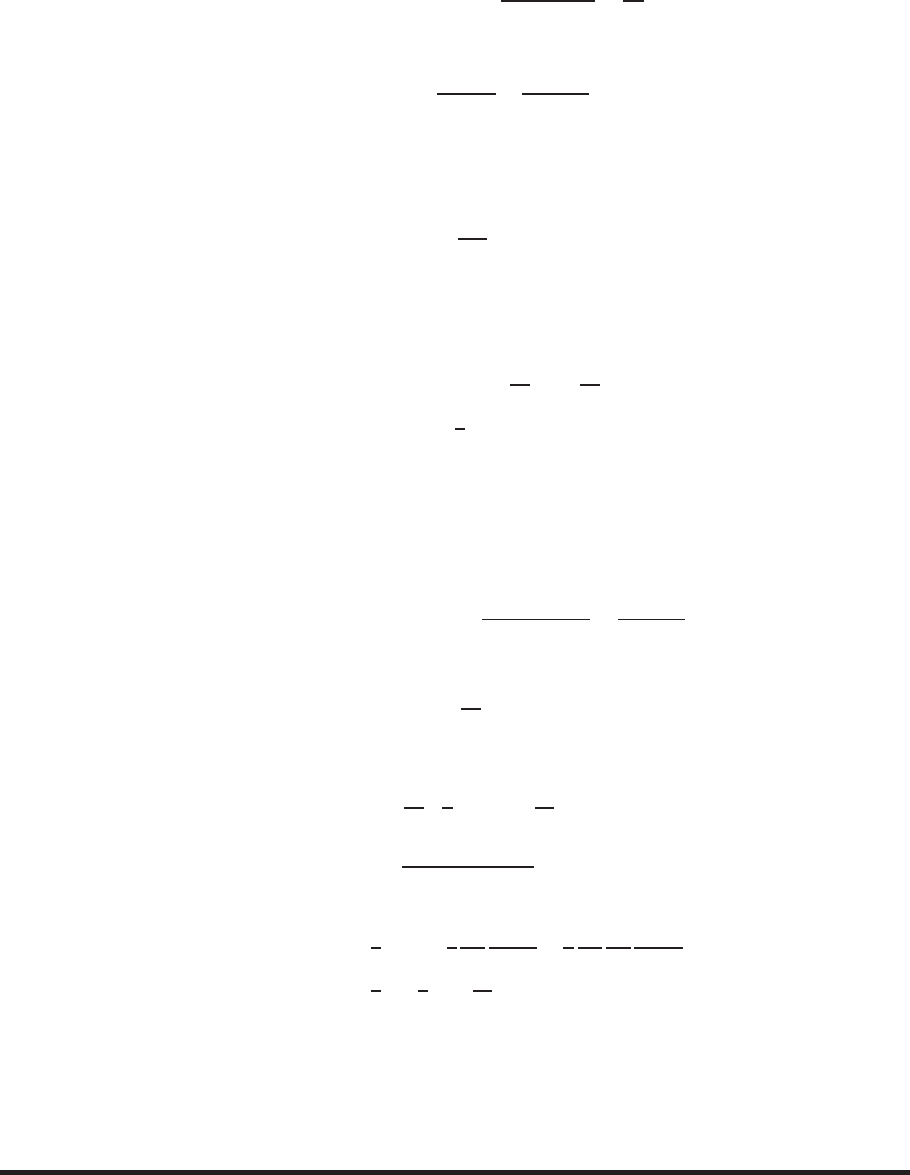
968 Chapter Ten /SOLUTIONS
7. The error bound in approximating tan(1) using the Taylor polynomial of degree three for f(x) = tan xabout x= 0 is:
|E3|=|f(1) −P3(x)| ≤ M· |1−0|4
4! =M
24
where |f(4)(x)| ≤ Mfor 0≤x≤1. Now,
f(4)(x) = 16 sin x
cos3x+24 sin3x
cos5x.
From a graph of f(4)(x), we see that f(4)(x)is increasing for xbetween 0and 1. Thus,
|f(4)(x)| ≤ |f(4)(1)|= 396,
so
|E3| ≤ 396
24 = 16.5.
This is not a very helpful error bound! The reason the error bound is so huge is that x= 1 is getting near the vertical
asymptote of the tangent graph, and the fourth derivative is enormous there.
Observing that any term in f′′(x)or f′′′(x)involving tan xis zero at x= 0, we calculate the Taylor polynomial of
degree 3:
P3(x) = 0 + x+ (0) x2
2! + (2) x3
3!
=x+1
3x3.
The approximation is P3(1), so the actual error is
E3= tan 1 −P3(1) = 1.557 −1.333 = 0.224,
which is much less than the bound.
8. The error bound in approximating 0.51/3using the Taylor polynomial of degree 3 for f(x) = (1 −x)1/3about x= 0 is:
|E3|=|f(0.5) −P3(0.5)| ≤ M· |0.5−0|4
4! =M(0.5)4
24 ,
where |f(4)(x)| ≤ Mfor 0≤x≤0.5. Now,
f(4)(x) = −80
81 (1 −x)−11/3.
By looking at the graph of (1 −x)−11/3, we see that |f(4)(x)|is maximized for xbetween 0and 0.5when x= 0.5.
Thus,
|f(4)| ≤ 80
81 1
2−11/3
=80
81 ·211/3,
so
|E3| ≤ 80 ·211/3·(0.5)4
81 ·24 = 0.033.
The Taylor polynomial of degree 3is
P3(x) = 1 + 1
3(−x) + 1
3−2
3
(−x)2
2! +1
3−2
3−5
3
(−x)3
3!
= 1 −1
3x−1
9x2−5
81 x3.
The approximation is P3(0.5), so the actual error is
E3= (0.5)1/3−P3(0.5) = 0.79370 −0.79784 = −0.00414,
which is much less than the bound.
Problems
9. (a) See the middle row of Table 10.1.
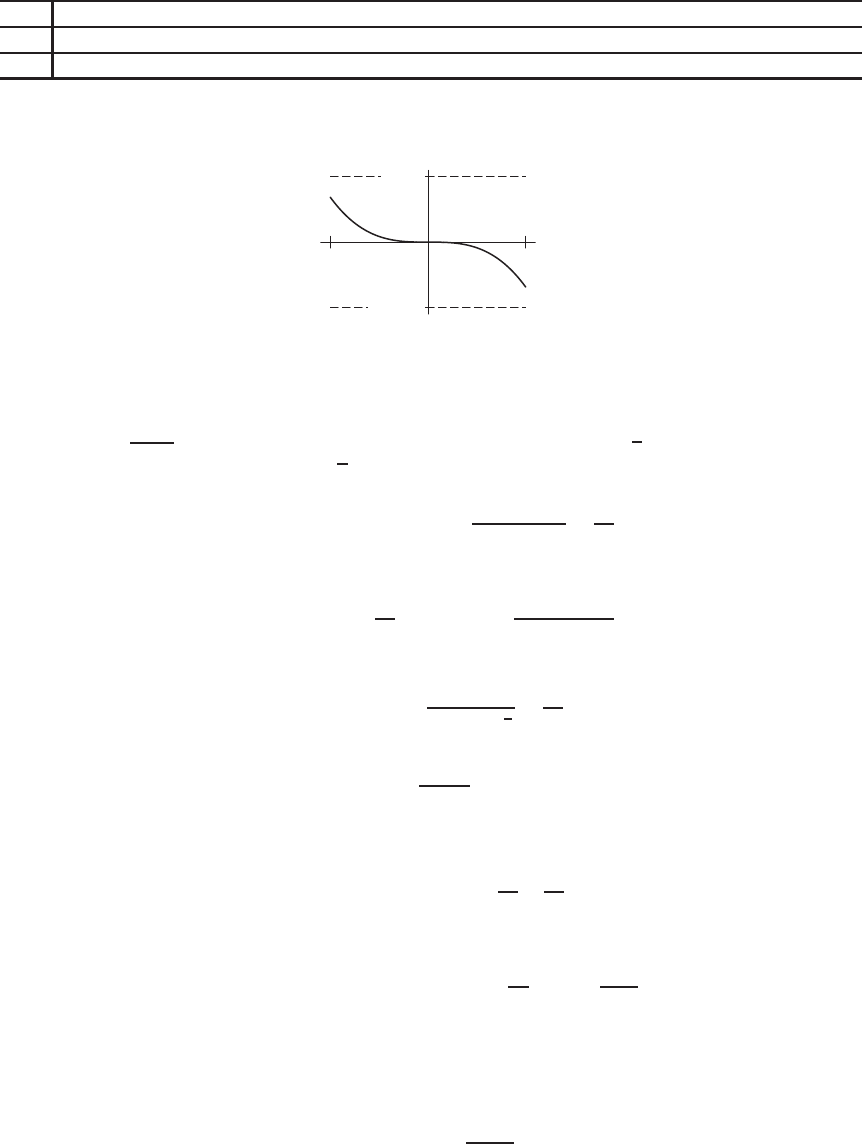
10.4 SOLUTIONS 969
(b) See the bottom row of Table 10.1.
Table 10.1
x−0.5−0.4−0.3−0.2−0.1 0 0.1 0.2 0.3 0.4 0.5
sin x−0.4794 −0.3894 −0.2955 −0.1987 −0.0998 0 0.0998 0.1987 0.2955 0.3894 0.4794
E10.0206 0.0106 0.0045 0.0013 0.0002 0−0.0002 −0.0013 −0.0045 −0.0106 −0.0206
(c) See Figure 10.8.
−0.5 0.5
−0.03
0.03
x
E1
Figure 10.8
The fact that the graph of E1lies between the horizontal lines at ±0.03 shows that |E1|<0.03 for −0.5≤
x≤0.5.
10. Let f(x) = √1 + x. We use a Taylor polynomial with x= 1 to approximate √2. The error bound for the Taylor
approximation of degree three for f(x) = √2about x= 0 is:
|E3|=|f(1) −P3(1)| ≤ M· |1−0|4
4! =M
24 ,
where |f(4)(x)| ≤ Mfor 0≤x≤1.
Now,
f(4)(x) = −15
16 (1 + x)−7/2=−15
16(1 + x)7/2.
Since 1≤(1 + x)7/2for xbetween 0and 1, we see that
|f(4)(x)|=15
16(1 + x)7
2≤15
16
for xbetween 0and 1. Thus,
|E3| ≤ 15
16 ·24 <0.039
11. (a) The third degree Taylor approximation of degree 3 of exaround 0 is
P3(x) = 1 + x+x2
2! +x3
3! .
Using the third-degree error bound, if |f(4)(x)| ≤ Mfor −2≤x≤2, then
|E3(x)|=|f(x)−P3(x)| ≤ M
4! · |x|4≤M24
4! .
Since |f(4)(x)|=ex, and exis increasing on [−2,2],
f(4)(x)≤e2for all x∈[−2,2].
So we can let M=e2and we get
|E3(x)|<e2·24
4! ≈5
(b) The actual maximum error is |e2−P3(2)|= 1.06.
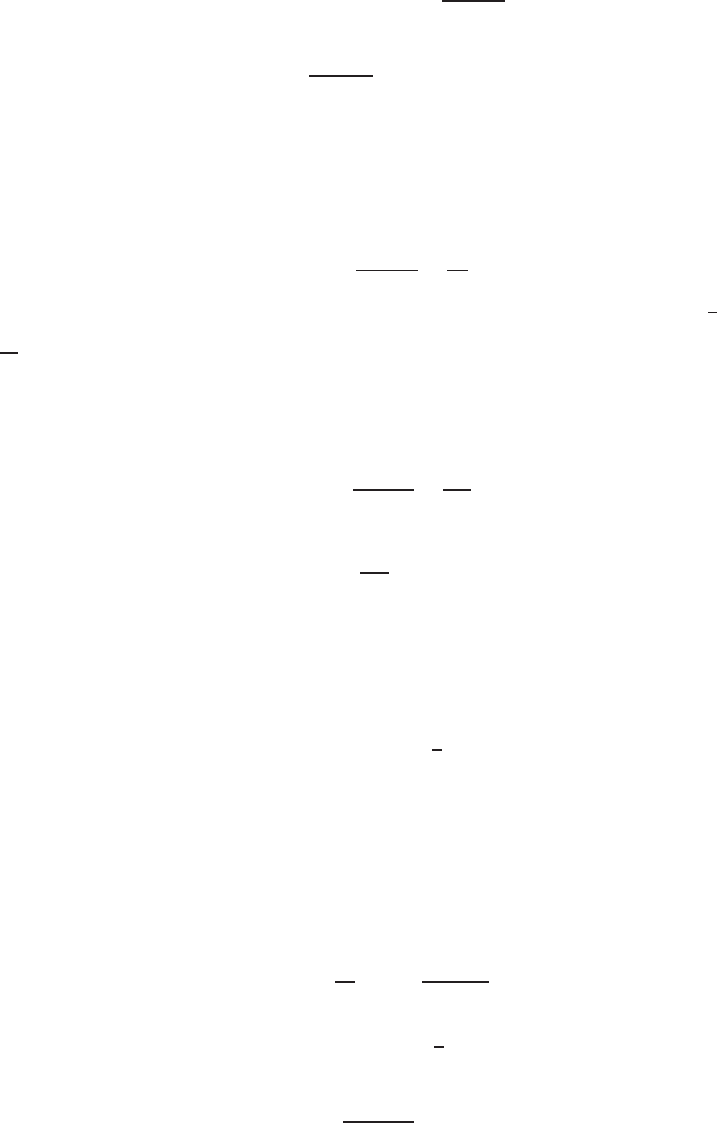
970 Chapter Ten /SOLUTIONS
12. For f(x) = cos x, note that fn+1(x), is ±cos xor ±sin x, no matter what nis. So
fn+1(x)<1for any x.
By the Lagrange error bound with M= 1, we have
En(x) = |f(x)−Pn(x)| ≤ |x|n+1
(n+ 1)! .
The right hand side of the equation above goes to zero as n→ ∞.
Hence we can always find nlarge enough that |x|n+1
(n+ 1)! <10−9for all x.
Note here that 10−9in the question does not play any role. We could have replaced it by any small number.
13. (a) θis the first degree approximation of f(θ) = sin θ; it is also the second degree approximation, since the next term in
the Taylor expansion is 0.
P1(θ) = θis an overestimate for 0< θ ≤1, and is an underestimate for −1≤θ < 0. (This can be seen easily from
a graph.)
(b) Using the second degree error bound, if |f(3)(θ)| ≤ Mfor −1≤θ≤1, then
|E2| ≤ M· |θ|3
3! ≤M
6.
For what value of Mis |f(3)(θ)| ≤ Mfor −1≤θ≤1? Well, |f(3) (θ)|=| − cos θ| ≤ 1. So |E2| ≤ 1
6= 0.17.
14. (a) θ−θ3
3! is the third degree Taylor approximation of f(θ) = sin θ; it is also the fourth degree approximation, since the
next term in the Taylor expansion is 0.
P3(θ)is an underestimate for 0< θ ≤1, and is an overestimate for −1≤θ < 0. (This can be checked with a
calculator.)
(b) Using the fourth degree error bound, if |f(5) (θ)| ≤ Mfor −1≤θ≤1, then
|E4| ≤ M· |θ|5
5! ≤M
120 .
For what value of Mis |f(5)(θ)| ≤ Mfor −1≤θ≤1? Since f(5)(θ) = cos θand |cos θ| ≤ 1, we have
|E4| ≤ 1
120 ≤0.0084.
15. (a) The Taylor polynomial of degree 0 about t= 0 for f(t) = etis simply P0(x) = 1. Since et≥1on [0,0.5], the
approximation is an underestimate.
(b) Using the zero degree error bound, if |f′(t)| ≤ Mfor 0≤t≤0.5, then
|E0| ≤ M· |t| ≤ M(0.5).
Since |f′(t)|=|et|=etis increasing on [0,0.5],
|f′(t)| ≤ e0.5<√4 = 2.
Therefore
|E0| ≤ (2)(0.5) = 1.
(Note: By looking at a graph of f(t)and its 0th degree approximation, it is easy to see that the greatest error occurs
when t= 0.5, and the error is e0.5−1≈0.65 <1.So our error bound works.)
16. (a) The second-degree Taylor polynomial for f(t) = etis P2(t) = 1 + t+t2/2. Since the full expansion of et=
1 + t+t2/2 + t3/6 + t4/24 + ···is clearly larger than P2(t)for t > 0,P2(t)is an underestimate on [0,0.5].
(b) Using the second-degree error bound, if |f(3)(t)| ≤ Mfor 0≤t≤0.5, then
|E2| ≤ M
3! · |t|3≤M(0.5)3
6.
Since |f(3)(t)|=et, and etis increasing on [0,0.5],
f(3)(t)≤e0.5<√4 = 2.
So
|E2| ≤ (2)(0.5)3
6<0.047.
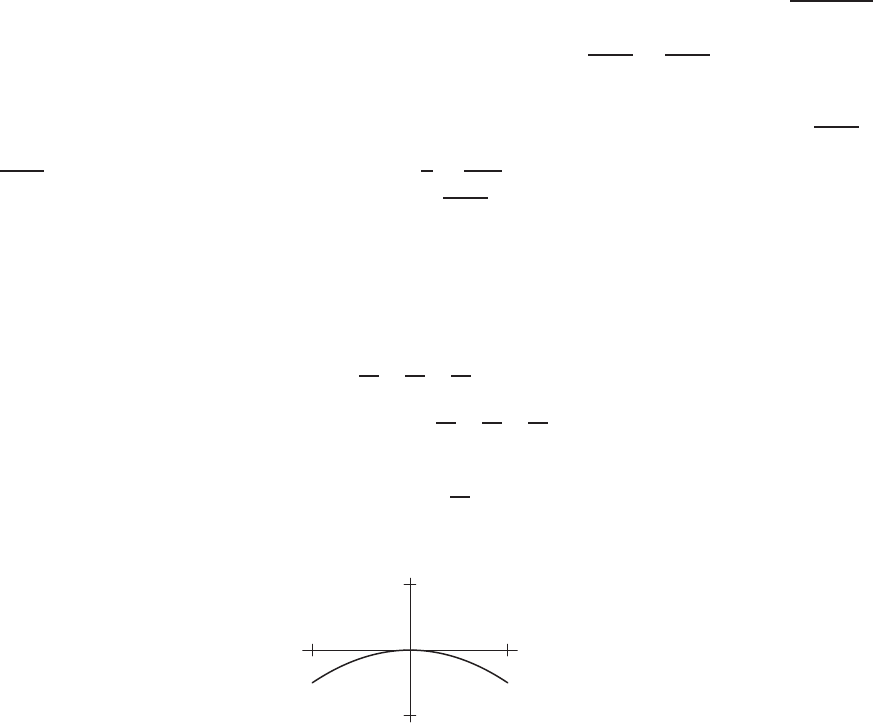
10.4 SOLUTIONS 971
17. (a) (i) The vertical distance between the graph of y= cos xand y=P10(x)at x= 6 is no more than 4, so
|Error in P10(6)| ≤ 4.
Since at x= 6 the cos xand P20(x)graphs are indistinguishable in this figure, the error must be less than the
smallest division we can see, which is about 0.2 so,
|Error in P20(6)| ≤ 0.2.
(ii) The maximum error occurs at the ends of the interval, that is, at x=−9, x = 9. At x= 9, the graphs of
y= cos xand y=P20(x)are no more than 1 apart, so
Maximum error in P20(x)
for −9≤x≤9≤1.
(b) We are looking for the largest x-interval on which the graphs of y= cos xand y=P10(x)are indistinguishable.
This is hard to estimate accurately from the figure, though −4≤x≤4certainly satisfies this condition.
18. The maximum possible error for the nth-degree Taylor polynomial about x= 0 approximating cos xis |En| ≤ M·|x−0|n+1
(n+1)! ,
where |cos(n+1) x| ≤ Mfor 0≤x≤1. Now the derivatives of cos xare simply cos x, sin x, −cos x, and −sin x. The
largest magnitude these ever take is 1, so |cos(n+1)(x)| ≤ 1, and thus |En| ≤ |x|n+1
(n+1)! ≤1
(n+1)! . The same argument
works for sin x.
19. By the results of Problem 18, if we approximate cos 1 using the nth degree polynomial, the error is at most 1
(n+1)! .
For the answer to be correct to four decimal places, the error must be less than 0.00005. Thus, the first nsuch that
1
(n+1)! <0.00005 will work. In particular, when n= 7,1
8! =1
40370 <0.00005, so the 7th degree Taylor polynomial
will give the desired result. For six decimal places, we need 1
(n+1)! <0.0000005. Since n= 9 works, the 9th degree
Taylor polynomial is sufficient.
20. The graph of E0looks like a parabola, and the graph shows
|E0|<0.01 for |x| ≤ 0.1.
(In fact |E0|<0.005 on this interval.) Since
cos x= 1 −x2
2! +x4
4! −x6
6! +···,
E0= cos x−1 = −x2
2! +x4
4! −x6
6! +···.
So, for small x,
E0≈ −x2
2,
and therefore the graph of E0is parabolic. See Figure 10.9.
−0.10.1
−0.01
0.01
x
E0
Figure 10.9
21. Since f(x) = ex, the (n+ 1)st derivative f(n+1)(x)is also ex, no matter what nis. Now fix a number xand let M=ex,
then |f(n+1)(t)| ≤ et≤exon the interval 0≤t≤x. (This works for x≥0; if x < 0then we can take M= 1.) The
important observation is that for any xthe same number Mbounds all the higher derivatives f(n+1)(x).

972 Chapter Ten /SOLUTIONS
By the error bound formula, we now have
|En(x)|=|ex−Pn(x)| ≤ M|x|n+1
(n+ 1)! for every n.
To show that the errors go to zero, we must show that for a fixed xand a fixed number M,
M
(n+ 1)! |x|n+1 →0as n→ ∞.
Since Mis fixed, we need only show that
1
(n+ 1)! |x|n+1 →0as n→ ∞.
This was shown in the text on page 562. Therefore, the Taylor series 1 + x+x2/2! + ···does converge to ex.
22.
sin x=x−x3
3! +x5
5! − ···
Write the error in approximating sin xby the Taylor polynomial of degree n= 2k+ 1 as Enso that
sin x=x−x3
3! +x5
5! − ···(−1)kx2k+1
(2k+ 1)! +En.
(Notice that (−1)k= 1 if kis even and (−1)k=−1if kis odd.) We want to show that if xis fixed, En→0as k→ ∞.
Since f(x) = sin x, all the derivatives of f(x)are ±sin xor ±cos x, so we have for all nand all x
|f(n+1)(x)| ≤ 1.
Using the bound on the error given in the text on page 562, we see that
|En| ≤ 1
(2k+ 2)! |x|2k+2.
By the argument in the text on page 562, we know that for all x,
|x|2k+2
(2k+ 2)! =|x|n+1
(n+ 1)! →0as n= 2k+ 1 → ∞.
Thus the Taylor series for sin xdoes converge to sin xfor every x.
23. (a) Since 4 arctan 1 = π, we approximate πby approximating 4 arctan xby Taylor polynomials with x= 1. Let
f(x) = 4 arctan x. We find the Taylor polynomial of fabout x= 0.
f(0) = 0
f′(x) = 4
1 + x2so f′(0) = 4
f′′(x) = −8x
(1 + x2)2so f′′(0) = 0
f′′′(x) = −8
(1 + x2)2+32x2
(1 + x2)3so f′′′(0) = −8.
Thus, the third degree Taylor polynomial for fis
F3(x) = 4x
1! −8
3! x3= 4x−4
3x3.
In particular,
F3(1) = 4 −4
3=8
3≈2.67.
Note: If you already have the Taylor series for 1/(1 + x2), the Taylor polynomial for arctan xcan also be found by
integration.
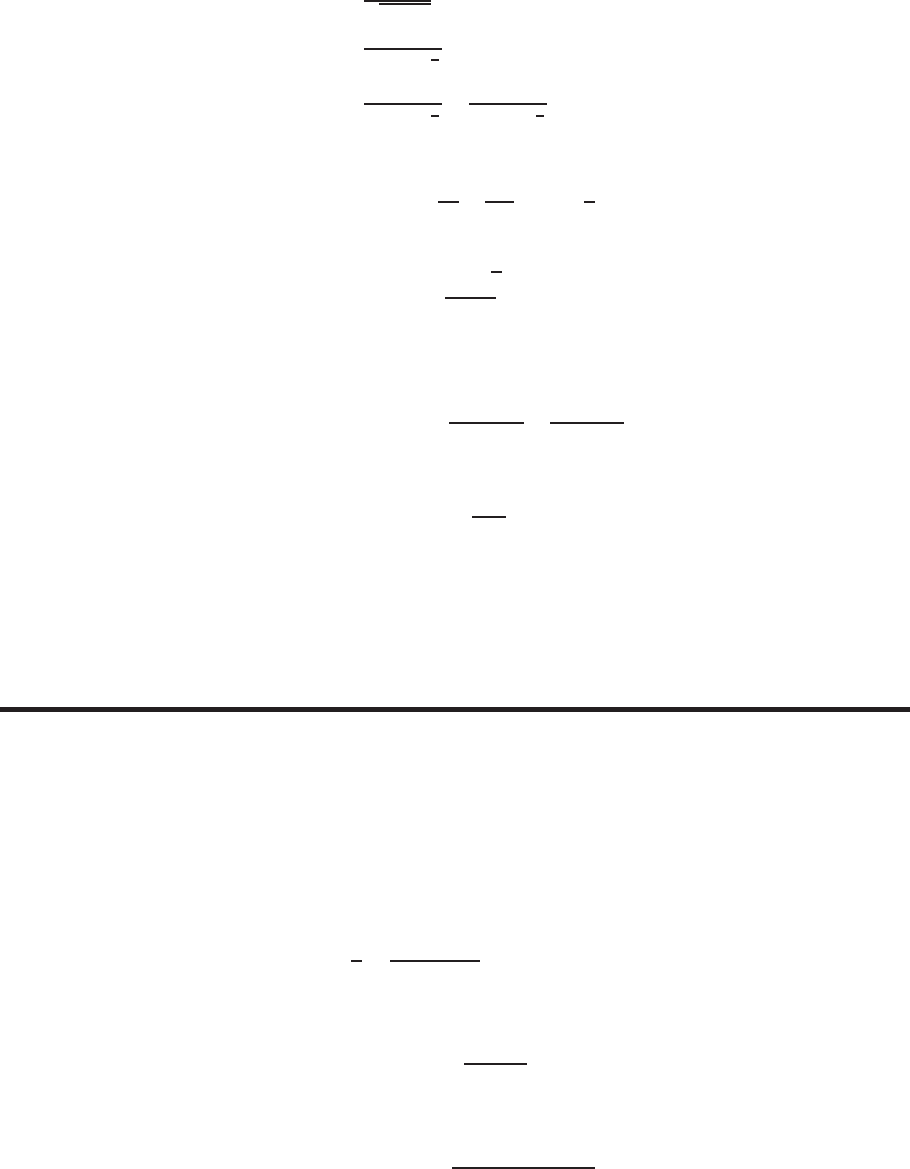
10.4 SOLUTIONS 973
(b) We now approximate πby looking at g(x) = 2 arcsin xabout x= 0 and substituting x= 1.
g(0) = 0
g′(x) = 2
√1−x2so g′(0) = 2
g′′(x) = 2x
(1 −x2)3
2
so g′′(0) = 0
g′′′(x) = 2
(1 −x2)3
2
+6x2
(1 −x2)5
2
so g′′′(0) = 2.
Thus, the third degree Taylor polynomial for gis
G3(x) = 2x
1! +2x3
3! = 2x+1
3x3.
In particular,
G3(1) = 7
3≈2.33.
Note: If you already have the Taylor series for 1/√1−x2, the Taylor polynomial for arcsin xcan also be found by
integration.
(c) To estimate the maximum possible error, |E3|, in the approximation using the arctangent, we need a bound on the
fourth derivative of f(x) = arctan xon 0≤x≤1. Since
f(4)(x) = −192x3
(1 + x2)4+96x
(1 + x2)3,
now use a graphing calculator to see that the maximum value of |f(4)(x)|, on 0≤x≤1is about 18.6. Thus,
|E3| ≤ 18.6
4! ≈0.78.
(Notice that π≈3.14 is within 0.78 of 2.67.)
(d) To estimate the maximum possible error, |En|, in an approximation using the arcsine, we need a bound on the
derivatives of g(x) = arcsin xon 0≤x≤1. The derivatives of arcsin xcontain terms of the form (1 −x2)−a, for
some positive a. As xgets close to 1, the value of (1 −x2)−aapproaches ∞. Thus, we cannot get a bound on the
derivatives of arcsin x, so the error formula does not give us a bound on |En|.
Strengthen Your Understanding
24. This statement is not correct, since f(x)and its Taylor approximation Pn(x)around ahave the same value at x=a. So
f(a) = Pn(a)for all n.
25. We can make the error |f(x)−Pn(x)|as small as we want for any given xby picking a large n. However, we may not
be able to find a Taylor polynomial that produces a small error for all values of xsimultaneously.
For example, if f(x) = cos x, then every Taylor polynomial Pn(x)goes to ±∞ as x→ ∞ and as x→ −∞. This
means that no matter what nwe choose, for large values of x, the value of Pn(x)is more than 1away from f(x).
26. A possible answer is sin x, or ex. Other examples are possible.
27. We’ll try using Taylor polynomials for the function f(x) = 1/x about x= 1. We have
f(x) = 1
x=1
1 + (x−1) =∞
X
n=0
(−1)n·(x−1)n
We know that, if Pn(x)is the nth-degree Taylor polynomial for f(x)at x= 1, then
|f(x)−Pn(x)| ≤ M
(n+ 1)! · |x−1|n+1,
where Mis the maximum value of the absolute value of the (n+ 1)st derivative of f(x)on [1,1.5]. The (n+ 1)st
derivative of f(x)is
f(n+1)(x) = (−1)n+1 ·(n+ 1)!
xn+2 ,
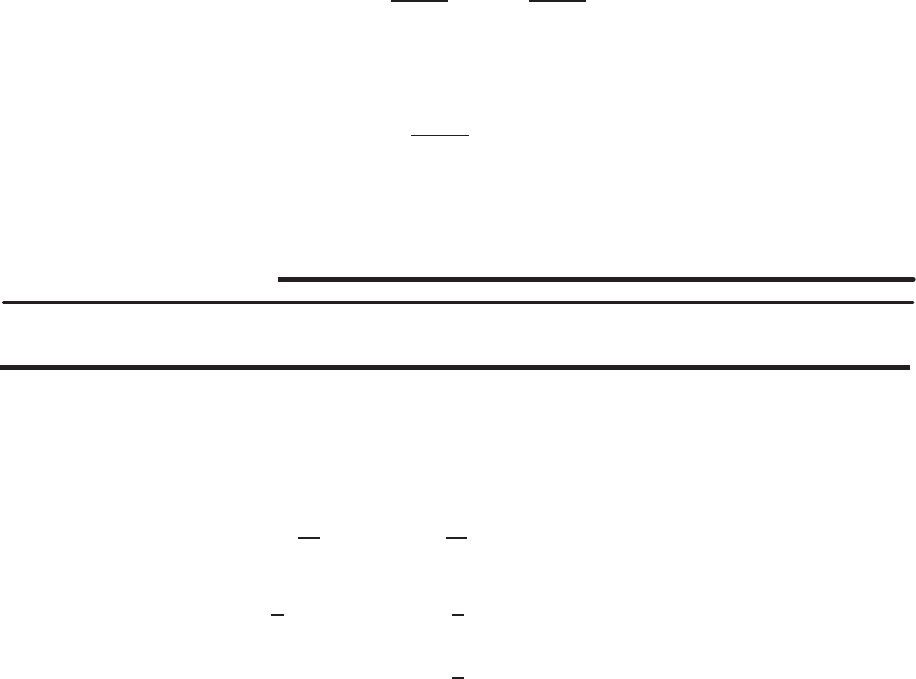
974 Chapter Ten /SOLUTIONS
and the absolute value of this derivative is never more than (n+ 1)! on [1,1.5]. So M= (n+ 1)!, and therefore
|f(x)−Pn(x)| ≤ |x−1|n+1.
We want to make sure this is less than 0.1on the interval [1,1.5], so we want |1.5−1|n+1 <0.1. This is true if n= 3,
so we use the Taylor polynomial
P3(x) = 1 −(x−1) + (x−1)2−(x−1)3.
28. According to the error formula we need max |f(n+1)| ≤ Mon the interval between 0 and x. Since we are working with
the second-degree Taylor polynomial we have n= 2.Therefore, we need a function and an interval such that the third
derivative of the function on that interval is less or equal to 4. We can choose, for example, f(x) = exand csmall enough
such that f(3)(x) = ex≤4on [−c, c]. There are many choices of c, for example c= 1 would work.
29. False. If fis itself a polynomial of degree nthen it is equal to its nth Taylor polynomial.
30. True. By Theorem 10.1, |En(x)|<10|x|n+1/(n+ 1)!. Since limn→∞ |x|n+1 /(n+ 1)! = 0,En(x)→0as n→ ∞,
so the Taylor series converges to f(x)for all x.
True
31. False. The Taylor series for fnear x= 0 always converges at x= 0, since P∞
n=0Cnxnat x= 0 is just the constant
C0.
32. True. When x= 1,∞
X
n=0
f(n)(0)
n!xn=∞
X
n=0
f(n)(0)
n!.
Since f(n)(0) ≥n!, the terms of this series are all greater than 1. So the series cannot converge
33. False. For example, if f(n)(0) = n!, then the Taylor series is
∞
X
n=0
f(n)(0)
n!xn=∞
X
n=0
xn,
which converges at x= 1/2.
Solutions for Section 10.5
Exercises
1. No, a Fourier series has terms of the form cos nx, not cosnx.
2. Not a Fourier series because terms are not of the form sin nx.
3. Yes. Terms are of the form sin nx and cos nx.
4. Yes. This is a Fourier series where the cos nx terms all have coefficients of zero.
5.
a0=1
2πZπ
−π
f(x)dx=1
2πZ0
−π−1dx+Zπ
0
1dx= 0
a1=1
πZπ
−π
f(x) cos x dx =1
πZ0
−π−cos x dx +Zπ
0
cos x dx
=1
π"−sin x
0
−π
+ sin x
π
0#= 0.
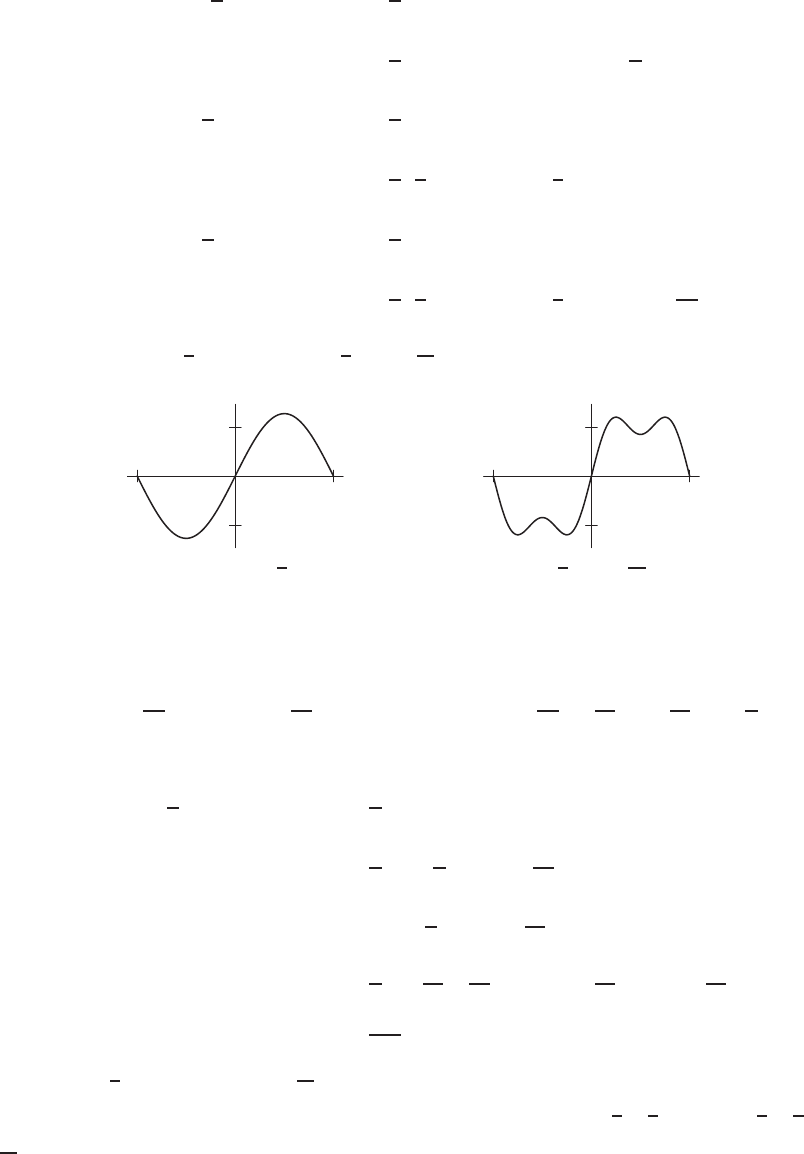
10.5 SOLUTIONS 975
Similarly, a2and a3are both 0. See Figure 10.10.
(In fact, notice f(x) cos nx is an odd function, so Rπ
−πf(x) cos nx = 0.)
b1=1
πZπ
−π
f(x) sin x dx =1
πZ0
−π−sin x dx +Zπ
0
sin x dx
=1
πcos x
0
−π
+ (−cos x)
π
0=4
π
b2=1
πZπ
−π
f(x)sin 2x dx =1
πZ0
−π−sin 2x dx +Zπ
0
sin 2x dx
=1
π1
2cos 2x
0
−π
+ (−1
2cos 2x)
π
0= 0.
b3=1
πZπ
−π
f(x)sin 3x dx =1
πZ0
−π−sin 3x dx +Zπ
0
sin 3x dx
=1
π1
3cos 3x
0
−π
+ (−1
3cos 3x)
π
0=4
3π.
Thus, F1(x) = F2(x) = 4
πsin xand F3(x) = 4
πsin x+4
3πsin 3x. See Figure 10.11.
−π
π
−1
1
x
F1(x)=F2(x) = 4
πsin x
Figure 10.10
−π
π
−1
1
x
F3(x)=4
πsin x+4
3πsin 3x
Figure 10.11
6. First,
a0=1
2πZπ
−π
f(x)dx =1
2πZ0
−π−x dx +Zπ
0
x dx=1
2π−x2
2
0
−π
+x2
2
π
0=π
2.
To find the ai’s, we use the integral table. For n≥1,
an=1
πZπ
−π
f(x)cos(nx)dx =1
πZ0
−π−xcos(nx)dx +Zπ
0
xcos(nx)dx
=1
π−x
nsin(nx)−1
n2cos(nx)
0
−π
+x
nsin(nx) + 1
n2cos(nx)
π
0
=1
π−1
n2+1
n2cos(−nπ) + 1
n2cos(nπ)−1
n2
=2
πn2(cos nπ −1)
Thus, a1=−4
π, a2= 0,and a3=−4
9π. See Figure 10.12. To find the bi’s, note that f(x)is even, so for n≥1,
f(x) sin(nx)is odd. Thus, Zπ
−π
f(x) sin(nx) = 0, so all the bi’s are 0. F1=F2=π
2−4
πcos x, F3=π
2−4
πcos x−
4
9πcos 3x. See Figure 10.13.
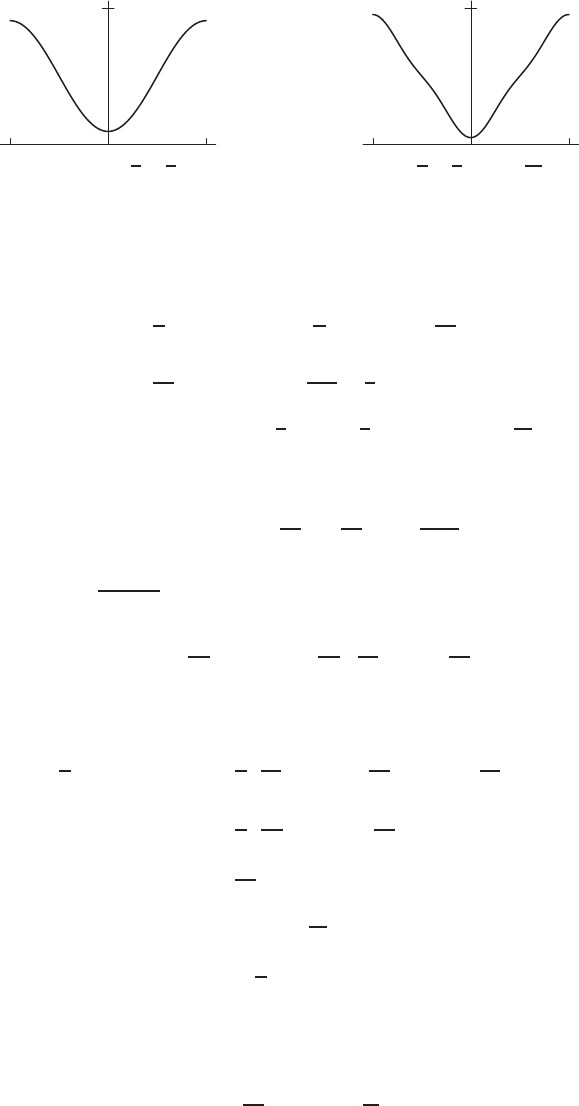
976 Chapter Ten /SOLUTIONS
−ππ
π
x
F1(x) = F2(x) = π
2−4
πcos x
Figure 10.12
−ππ
π
x
F3(x) = π
2−4
πcos x−4
9πcos 3x
Figure 10.13
7. The energy of the function f(x)is
E=1
πZπ
−π
(f(x))2dx =1
πZπ
−π
x2dx =1
3πx3
π
−π
=1
3π(π3−(−π3)) = 2π3
3π=2
3π2= 6.57974.
From Problem 6, we know all the bi’s are 0 and a0=π
2,a1=−4
π,a2= 0 ,a3=−4
9π. Therefore the energy in the
constant term and first three harmonics is
A2
0+A2
1+A2
2+A2
3= 2a2
0+a2
1+a2
2+a2
3
= 2 π2
4+16
π2+ 0 + 16
81π2= 6.57596
which means that they contain 6.57596
6.57974 = 0.99942 ≈99.942% of the total energy.
8. First, we find a0.
a0=1
2πZπ
−π
x2dx =1
2πx3
3
π
−π=π2
3
To find an, n ≥1,we use the integral table (III-15 and III-16).
an=1
πZπ
−π
x2cos nx dx =1
πx2
nsin(nx) + 2x
n2cos(nx)−2
n3sin(nx)
π
−π
=1
π2π
n2cos(nπ) + 2π
n2cos(−nπ)
=4
n2cos(nπ)
Again, cos(nπ) = (−1)nfor all integers n, so an= (−1)n4
n2.Note that
bn=1
πZπ
−π
x2sin nx dx.
x2is an even function, and sin nx is odd, so x2sin nx is odd. Thus Rπ
−πx2sin nx dx = 0,and bn= 0 for all n.
We deduce that the nth Fourier polynomial for f(where n≥1) is
Fn(x) = π2
3+
n
X
i=1
(−1)i4
i2cos(ix).
In particular, we have the graphs in Figure 10.14.
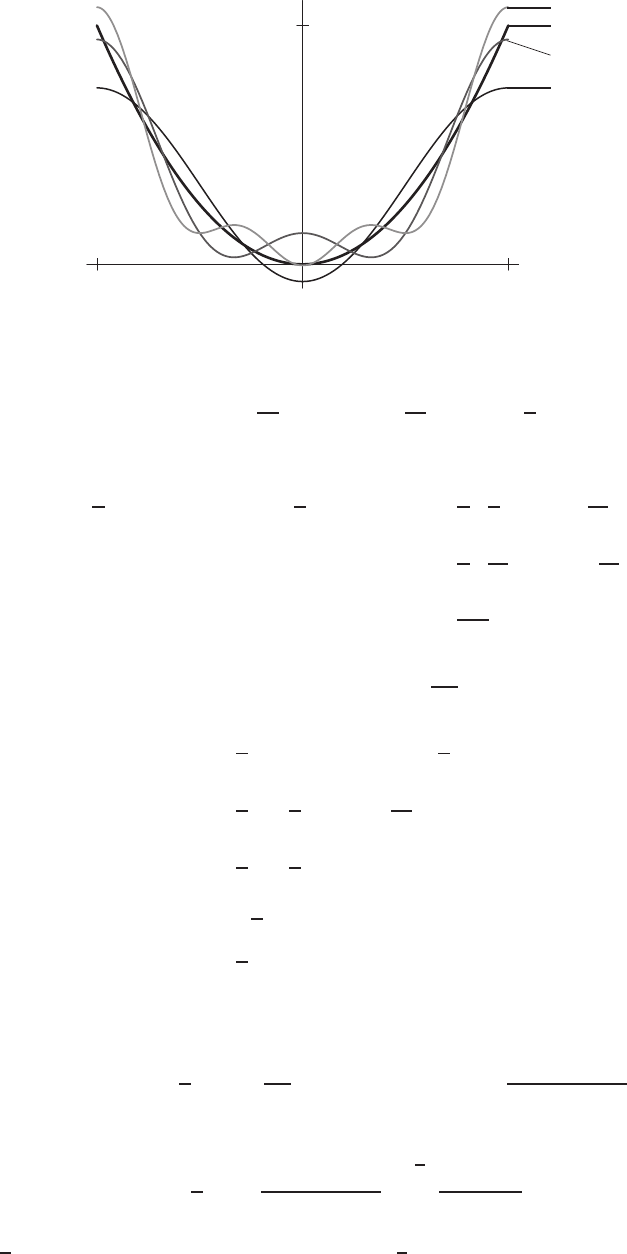
10.5 SOLUTIONS 977
π π
π2
✛F1(x)
✐F2(x)
✛f(x) = x2
✛F3(x)
x
Figure 10.14
9.
a0=1
2πZπ
−π
h(x)dx =1
2πZπ
0
x dx =π
4
As in Problem 10, we use the integral table (III-15 and III-16) to find formulas for anand bn.
an=1
πZπ
−π
h(x) cos(nx)dx =1
πZπ
0
xcos nx dx =1
πx
nsin(nx) + 1
n2cos(nx)
π
0
=1
π1
n2cos(nπ)−1
n2
=1
n2πcos(nπ)−1.
Note that since cos(nπ) = (−1)n, an= 0 if nis even and an=−2
n2πif nis odd.
bn=1
πZπ
−π
h(x)cos(nx)dx =1
πZπ
0
xsin x dx
=1
π−x
ncos(nx) + 1
n2sin(nx)
π
0
=1
π−π
ncos(nπ)
=−1
ncos(nπ)
=1
n(−1)n+1 if n≥1
We have that the nth Fourier polynomial for h(for n≥1) is
Hn(x) = π
4+
n
X
i=1 1
i2πcos(iπ)−1·cos(ix) + (−1)i+1 sin(ix)
i.
This can also be written as
Hn(x) = π
4+
n
X
i=1
(−1)i+1 sin(ix)
i+
[n
2]
X
i=1
−2
(2i−1)2πcos((2i−1)x)
where n
2denotes the biggest integer smaller than or equal to n
2. In particular, we have the graphs in Figure 10.15.
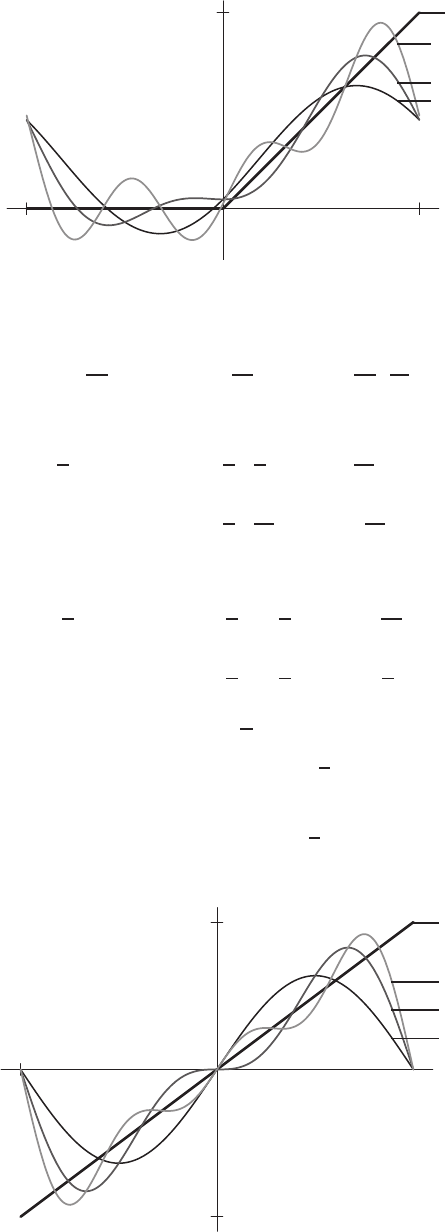
978 Chapter Ten /SOLUTIONS
−ππ
π
✛H1(x)
✛H2(x)
✛H3(x)
✛h(x)
x
Figure 10.15
10. To find the nth Fourier polynomial, we must come up with a general formula for anand bn. First, we find a0.
a0=1
2πZπ
−π
g(x)dx =1
2πZπ
−π
x dx =1
2πx2
2
π
−π= 0
Now we use the integral table (III-15 and III-16) to find anand bnfor n≥1.
an=1
πZπ
−π
xcos nx dx =1
πx
nsin(nx) + 1
n2cos(nx)
π
−π
=1
π1
n2cos(nπ)−1
n2cos(−nπ)= 0
(Note that since xcos nx is odd, we could have deduced that Rπ
−πxcos nx = 0.)
bn=1
πZπ
−π
xsin nx dx =1
π−x
ncos(nx) + 1
n2sin(nx)
π
−π
=1
π−π
ncos(nπ)−π
ncos(−nπ)
=−2
ncos(nπ)
Notice that cos(nπ) = (−1)nfor all integers n, so bn= (−1)n+1(2
n).
Thus the nth Fourier polynomial for gis
Gn(x) =
n
X
i=1
(−1)i+1 2
isin(ix).
In particular, we have the graphs in Figure 10.16.
−π
π
−π
π✛g(x)
✛G1(x)
✛G2(x)
✛G3(x)
x
Figure 10.16
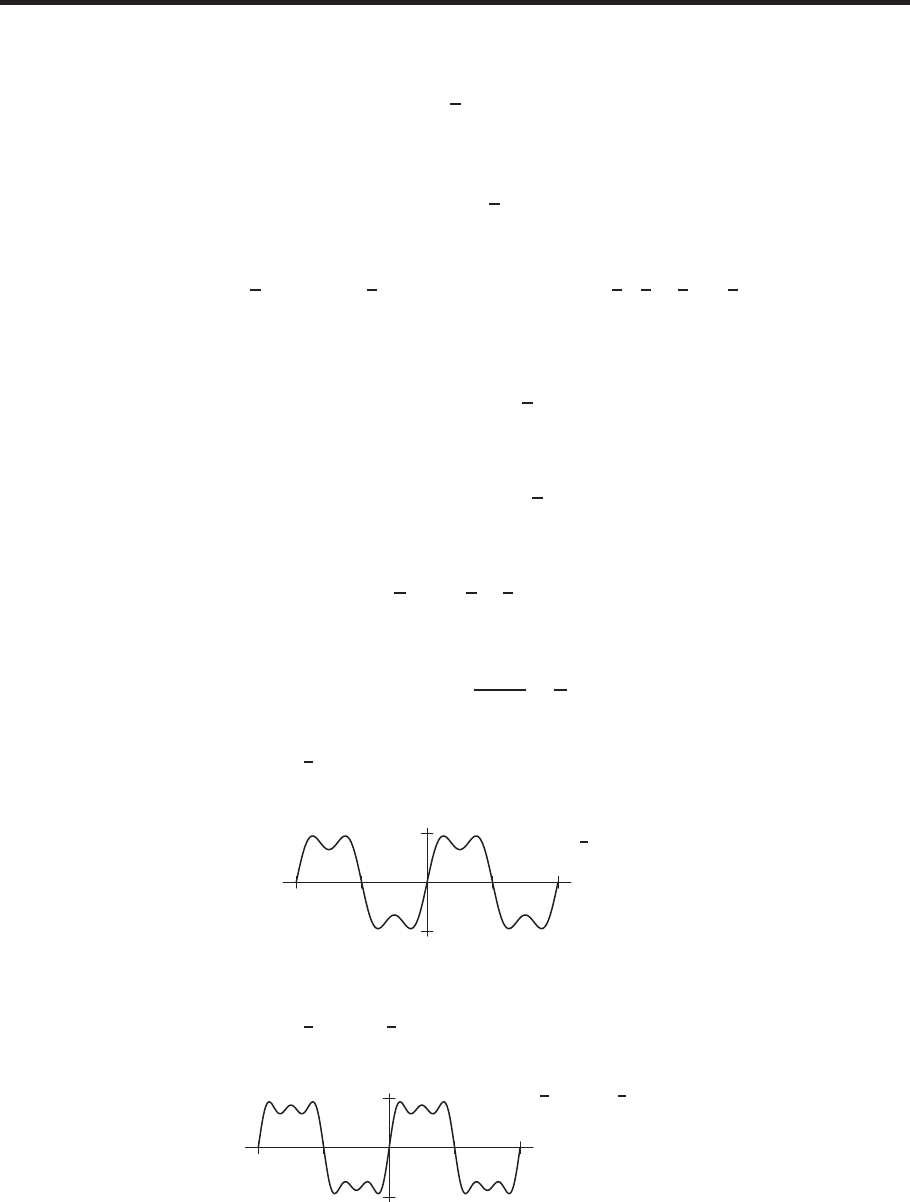
10.5 SOLUTIONS 979
Problems
11. The period of f(x)is equal to 2. Since a0, the constant term of the Fourier series of f(x)is the average value of fover
the interval [−1,1], it is given by the following integral:
a0=1
2Z1
−1|x|dx.
By looking at the graph of f(x)between −1and 1, we see that the area under fis equal to 1. Multiplying this by 1/2we
have
a0=1
2.
We can check this analytically:
a0=1
2Z1
−1|x|dx =1
2Z0
−1
(−x)dx +Z1
0
xdx=1
21
2+1
2=1
2.
12. In Problem 10 we found that the Fourier polynomial of g(x) = xof degree nis:
Gn(x) =
n
X
i=1
(−1)i+1 2
isin(ix).
Hence the Fourier series of g(x)is:
g(x) = x=∞
X
i=1
(−1)i+1 2
isin(ix).
By substituting x=π/2and expanding we get
π
2= 2 −2
3+2
5− ···
Factoring 2 out from the right hand side and dividing both sides by 2, we have
∞
X
k=1
(−1)k+1 1
2k−1=π
4.
13. (a) (i) The graph of y= sin x+1
3sin 3xis in Figure 10.17.
−2π−ππ2π
−1
1y= sin x+1
3sin 3x
x
y
Figure 10.17
(ii) The graph of y= sin x+1
3sin 3x+1
5sin 5xis in Figure 10.17.
−2π−ππ2π
−1
1y= sin x+1
3sin 3x+1
5sin 5x
x
y
Figure 10.18
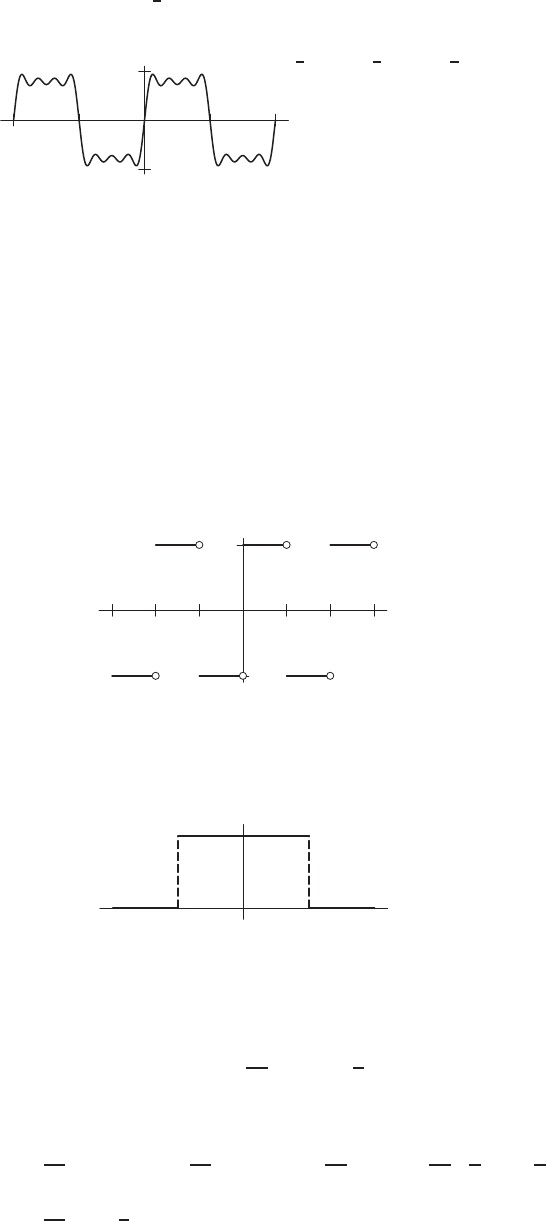
980 Chapter Ten /SOLUTIONS
(b) Following the pattern, we add the term 1
7sin 7xto get Figure 10.19.
−2π−ππ2π
−1
1y= sin x+1
3sin 3x+1
5sin 5x+1
7sin 7x
x
y
Figure 10.19
(c) The equation is
f(x) =
.
.
..
.
.
1−2π≤x<−π
−1−π≤x < 0
1 0 ≤x < π
−1π≤x < 2π
.
.
..
.
.
The square wave function is not continuous at x= 0,±π, ±2π,.... See Figure 10.20.
−3π−2π−ππ2π3π
−1
1
x
y
Figure 10.20
14. (a) The graph of g(x)is in Figure 10.21.
−π−π/2π/2π
1
x
g(x)
Figure 10.21
First find the Fourier coefficients: a0is the average value of gon [−π, π]so from the graph, it is clear that
a0=1
2π(π×1) = 1
2,
or analytically,
a0=1
2πZπ
−π
g(x)dx =1
2πZπ/2
−π/2
1dx =1
2πx
π/2
−π/2
=1
2ππ
2−−π
2
=1
2π(π) = 1
2,
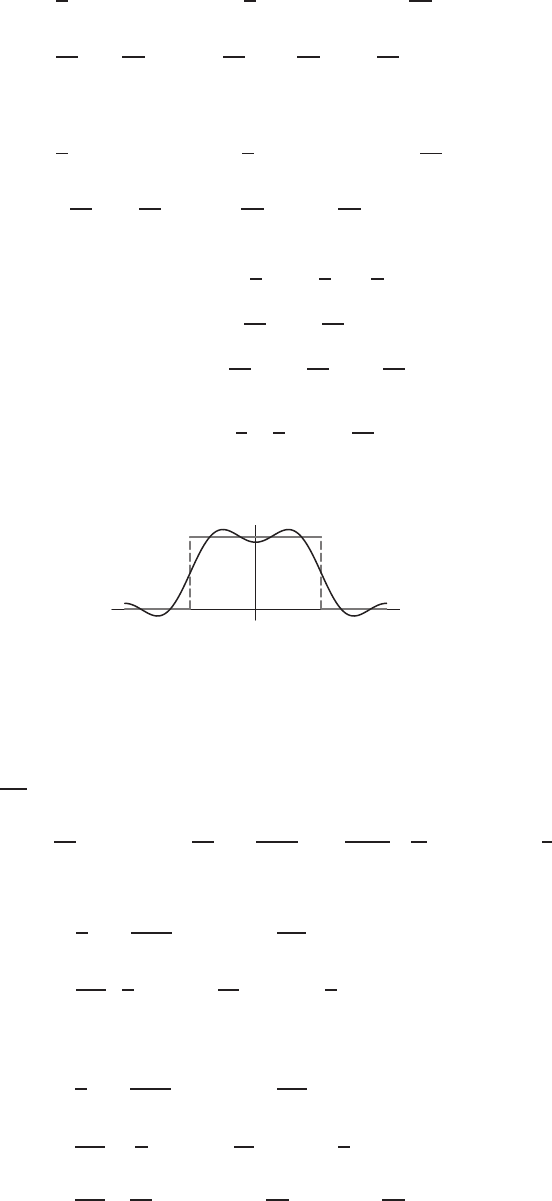
10.5 SOLUTIONS 981
ak=1
πZπ
−π
g(x) cos kx dx =1
πZπ/2
−π/2
cos kx dx =1
kπ sin kx
π/2
−π/2
=1
kπ sin kπ
2−sin −kπ
2=1
kπ 2 sin kπ
2,
bk=1
πZπ
−π
g(x)sin kx dx =1
πZπ/2
−π/2
sin kx dx =−1
kπ cos kx
π/2
−π/2
=−1
kπ cos kπ
2−cos −kπ
2.=−1
kπ (0) = 0
So,
a1=1
π2 sin π
2=2
π,
a2=1
2π2 sin 2π
2= 0,
a3=1
3π2 sin 3π
2=−2
3π,
which gives
F3(x) = 1
2+2
πcos x−2
3πcos 3x.
See Figure 10.22.
−ππ/2π/2π
1
x
g(x)
F3(x)
Figure 10.22
(b) There are cosines instead of sines (but the energy spectrum remains the same).
15. We have f(x) = x,0≤x < 1. Let t= 2πx −π. Notice that as xvaries from 0to 1,tvaries from −πto π. Thus
if we rewrite the function in terms of t, we can find the Fourier series in terms of tin the usual way. To do this, let
g(t) = f(x) = x=t+π
2πon −π≤t<π. We now find the fourth degree Fourier polynomial for g.
ao=1
2πZπ
−π
g(t)dt=1
2πZπ
−π
t+π
2πdt =1
(2π)2t2
2+πt
π
−π
=1
2
Notice, a0is the average value of both fand g. For n≥1,
an=1
πZπ
−π
t+π
2πcos(nt)dt =1
2π2Zπ
−π
(tcos(nt) + πcos(nt))dt
=1
2π2ht
nsin(nt) + 1
n2cos(nt) + π
nsin(nt)i
π
−π
= 0.
bn=1
πZπ
−π
t+π
2πsin(nt)dt =1
2π2Zπ
−π
(tsin(nt) + πsin(nt)) dt
=1
2π2h−t
ncos(nt) + 1
n2sin(nt)−π
ncos(nt)i
π
−π
=1
2π2(−4π
ncos(πn)) = −2
πn cos(πn) = 2
πn (−1)n+1.
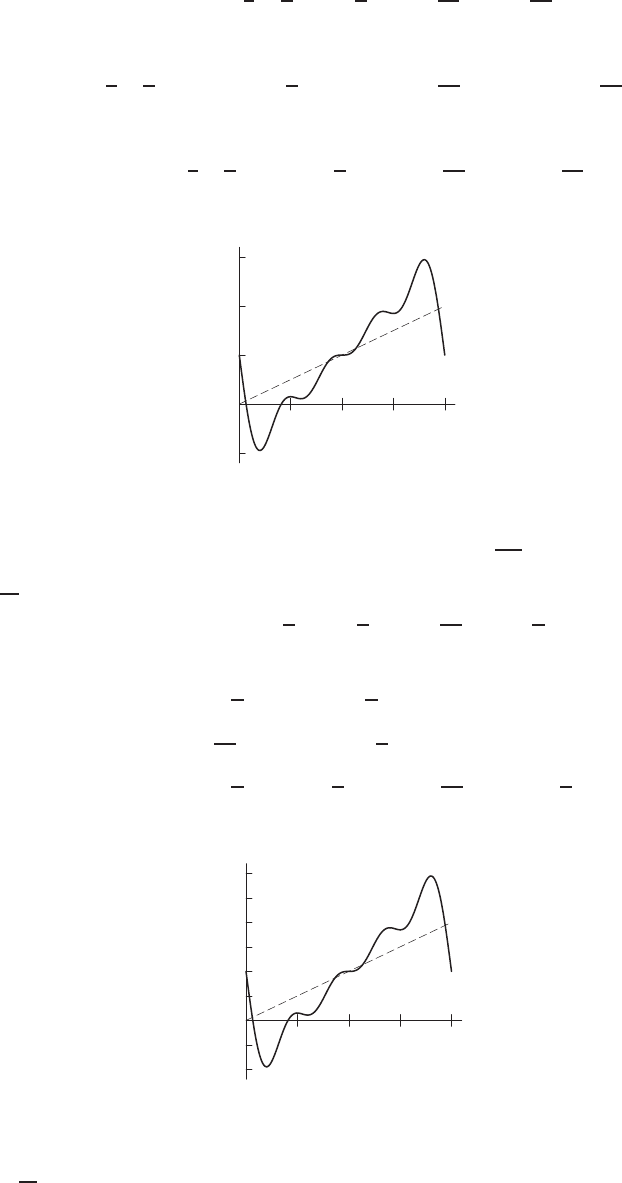
982 Chapter Ten /SOLUTIONS
We get the integrals for anand bnusing the integral table (formulas III-15 and III-16).
Thus, the Fourier polynomial of degree 4for gis:
G4(t) = 1
2+2
πsin t−1
πsin 2t+2
3πsin 3t−1
2πsin 4t.
Now, since g(t) = f(x), the Fourier polynomial of degree 4for fcan be found by replacing tin terms of xagain. Thus,
F4(x) = 1
2+2
πsin(2πx −π)−1
πsin(4πx −2π) + 2
3πsin(6πx −3π)−1
2πsin(8πx −4π).
Now, using the fact that sin(x−π) = −sin xand sin(x−2π) = sin x, etc., we have:
F4(x) = 1
2−2
πsin(2πx)−1
πsin(4πx)−2
3πsin(6πx)−1
2πsin(8πx).
See Figure 10.23.
1
1f(x) = x
F4(x)
x
Figure 10.23
16. Since the period is 2, we make the substitution t=πx −π. Thus, x=t+π
π. We find the Fourier coefficients. Notice
that all of the integrals are the same as in Problem 15 except for an extra factor of 2. Thus, a0= 1,an= 0, and
bn=4
πn (−1)n+1 , so:
G4(t) = 1 + 4
πsin t−2
πsin 2t+4
3πsin 3t−1
πsin 4t.
Again, we substitute back in to get a Fourier polynomial in terms of x:
F4(x) = 1 + 4
πsin(πx −π)−2
πsin(2πx −2π)
+4
3πsin(3πx −3π)−1
πsin(4πx −4π)
= 1 −4
πsin(πx)−2
πsin(2πx)−4
3πsin(3πx)−1
πsin(4πx).
See Figure 10.24.
1 2
−1
1
2
3
f(x) = x
F4(x)
x
Figure 10.24
Notice in this case, the terms in our series are sin(nπx), not sin(2πnx), as in Problem 15. In general, the terms will
be sin(n2π
bx), where bis the period.
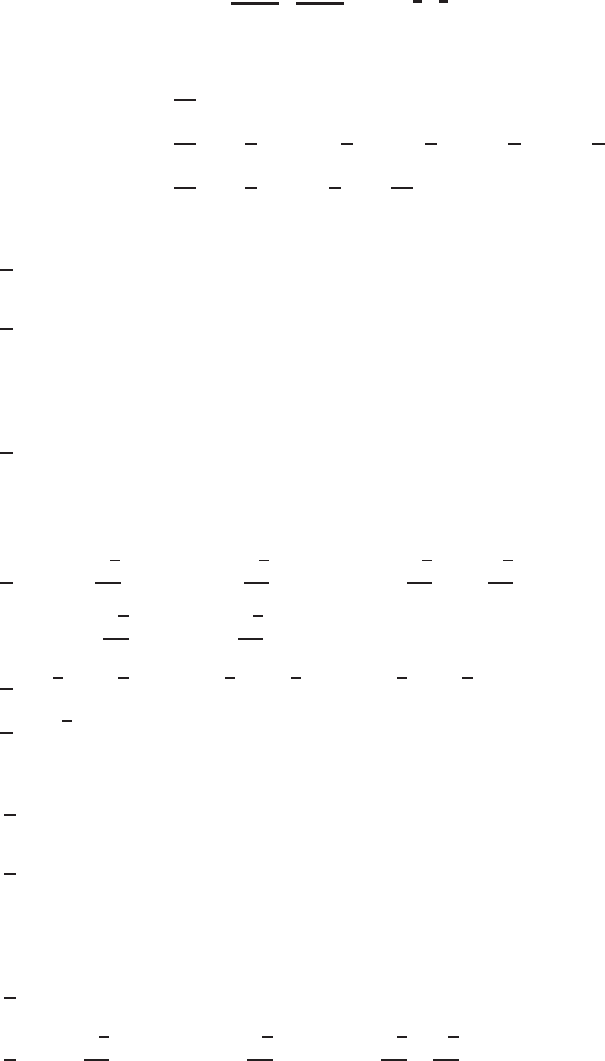
10.5 SOLUTIONS 983
17. The signal received on earth is in the form of a periodic function h(t), which can be expanded in a Fourier series
h(t) = a0+a1cos t+a2cos 2t+a3cos 3t+···
+b1sin t+b2sin 2t+b3sin 3t+···
If the periodic noise consists of only the second and higher harmonics of the Fourier series, then the original signal
contributed the fundamental harmonic plus the constant term, i.e.,
a0
|{z}
constant term
+a1cos t+b1sin t
| {z }
fundamental harmonic
=Acos t
|{z}
original signal
.
In order to find A, we need to find a0,a1, and b1. Looking at the graph of h(t), we see
a0=average value of h(t) = 1
2π(Area above the x-axis – Area below the x-axis)
=1
2πh80 π
2−50 π
4+ 30 π
4+ 30 π
4+ 50 π
4i
=1
2πh80 π
2−80 π
2i=1
2π·0,= 0
a1=1
πZπ
−π
h(t) cos t dt
=1
πZ−3π/4
−π−50 cos t dt +Z−π/2
−3π/4
0 cos t dt +Z−π/4
−π/2−30 cos t dt
+Zπ/4
−π/4
80 cos t dt +Zπ/2
π/4−30 cos t dt +Z3π/4
π/2
0 cos t dt +Zπ
3π/4−50 cos t dt
=1
π"−50 sin t
−3π/4
−π−30 sin t
−π/4
−π/2
+80 sin t
π/4
−π/4−30 sin t
π/2
π/4−50 sin t
π
3π/4#
=1
π−50 −√2
2−0−30 −√2
2−(−1)+ 80 √2
2−−√2
2
−30 1−√2
2−50 0−√2
2
=1
π[25√2 + 15√2−30 + 40√2 + 40√2−30 + 15√2 + 25√2]
=1
π[160√2−60] = 52.93,
b1=1
πZπ
−π
h(t) sin t dt
=1
πZ−3π/4
−π−50 sin t dt +Z−π/2
−3π/4
0 sin t dt +Z−π/4
−π/2−30 sin t dt
+Zπ/4
−π/4
80 sin t dt +Zπ/2
π/4−30 sin t dt +Z3π/4
π/2
0 sin t dt +Zπ
3π/4−50 sin t dt
=1
π"50 cos t
−3π/4
−π
+ 30 cos t
−π/4
−π/2−80 cos t
π/4
−π/4
+ 30 cos t
π/2
π/4
+ 50 cos t
π
3π/4#
=1
π50 −√2
2−(−1)+ 30 √2
2−0−80 √2
2−√2
2
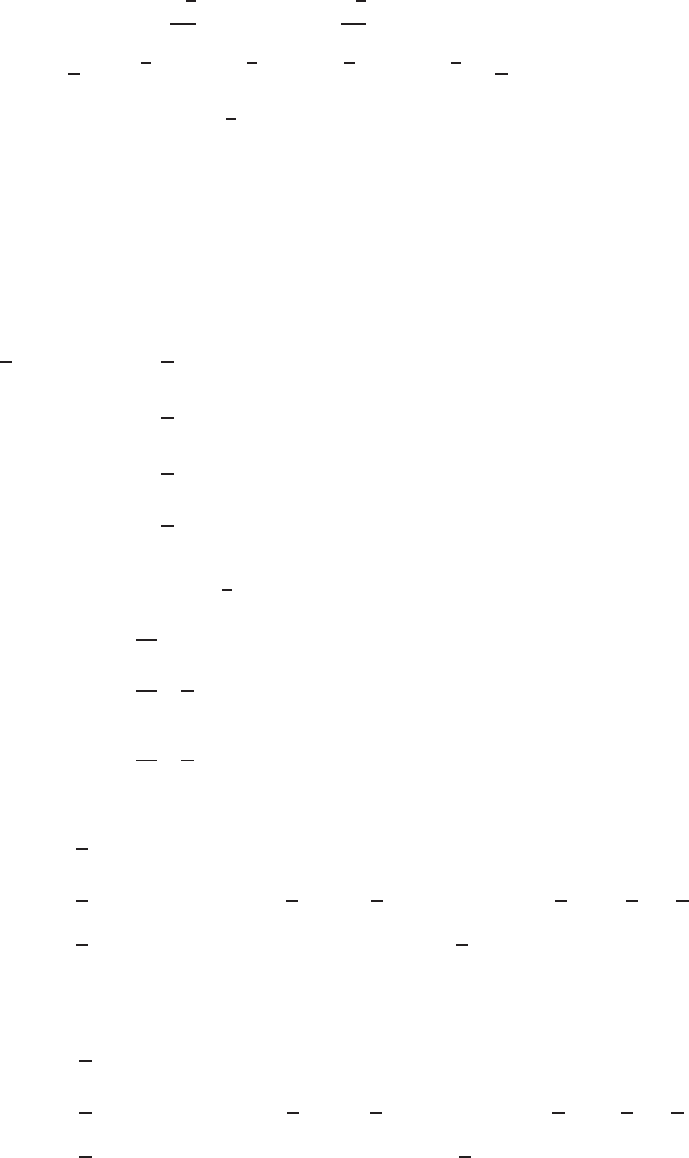
984 Chapter Ten /SOLUTIONS
+30 0−√2
2+ 50 −1−(−√2
2)
=1
π−25√2 + 50 + 15√2−0−15√2−50 + 25√2=1
π(0) = 0.
Also, we could have just noted that b1=1
πRπ
−πh(t) sin t dt = 0 because h(t) sin tis an odd function.
Substituting in, we get
a0+a1cos t+b1sin t= 0 + 52.93 cos t+ 0 = Acos t.
So A= 52.93.
18. The energy spectrum of the flute shows that the first two harmonics have equal energies and contribute the most energy
by far. The higher harmonics contribute relatively little energy. In contrast, the energy spectrum of the bassoon shows the
comparative weakness of the first two harmonics to the third harmonic which is the strongest component.
19. Let f(x) = akcos kx +bksin kx. Then the energy of fis given by
1
πZπ
−π
(f(x))2dx =1
πZπ
−π
(akcos kx +bksin kx)2dx
=1
πZπ
−π
(a2
kcos2kx −2akbkcos kx sin kx +b2
ksin2kx)dx
=1
πa2
kZπ
−π
cos2kx dx −2akbkZπ
−π
cos kx sin kx dx +b2
kZπ
−π
sin2kx dx
=1
πa2
kπ−2akbk·0 + b2
kπ=a2
k+b2
k.
20. Since each square in the graph has area (π
4)·(0.2),
a0=1
2πZπ
−π
f(x)dx
=1
2π·(π
4)·(0.2) [Number of squares under graph above x-axis
– Number of squares above graph below xaxis]
≈1
2π·(π
4)·(0.2) ·[13 + 11 −14] = 0.25.
Approximate the Fourier coefficients using Riemann sums.
a1=1
πZπ
−π
f(x) cos x dx
≈1
πhf(−π) cos(−π) + f−π
2cos −π
2+f(0) cos(0) + fπ
2cos π
2i·π
2
=1
π[(0.92)(−1) + (1)(0) + (−1.7)(1) + (0.7)(0)] ·π
2
=−1.31
Similarly for b1:
b1=1
πZπ
−π
f(x) sin x dx
≈1
πhf(−π) sin(−π) + f−π
2sin −π
2+f(0) sin(0) + fπ
2sin π
2i·π
2
=1
π[(0.92)(0) + (1)(−1) + (−1.7)(0) + (0.7)(1)] ·π
2
=−0.15.
So our first Fourier approximation is
F1(x) = 0.25 −1.31 cos x−0.15 sin x.
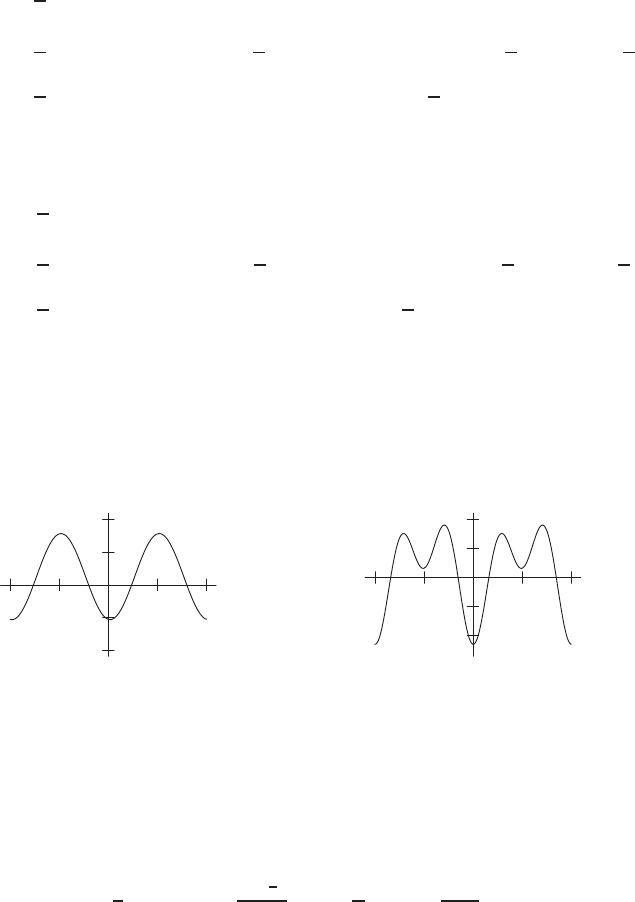
10.5 SOLUTIONS 985
See Figure 10.25
Similarly for a2:
a2=1
πZπ
−π
f(x)cos 2x dx
≈1
πhf(−π) cos(−2π) + f−π
2cos(−π) + f(0) cos(0) + fπ
2cos(−π)i·π
2
=1
π[(0.92)(1) + (1)(−1) + (−1.7)(1) + (0.7)(−1)] ·π
2
=−1.24
Similarly for b2:
b2=1
πZπ
−π
f(x) sin 2x dx
≈1
πhf(−π) sin(−2π) + f−π
2sin(−π) + f(0) sin(0) + fπ
2sin(−π)i·π
2
=1
π[(0.92)(0) + (1)(0) + (−1.7)(0) + (0.7)(0)] ·π
2
= 0.
So our second Fourier approximation is
F2(x) = 0.25 −1.31 cos x−0.15 sin x−1.24 cos 2x.
See Figure 10.26.
−2π−ππ2π
−2
1
−1
2
x
y
y=F1(x)
Figure 10.25
−2π−ππ2π
−2
1
2
x
yy=F2(x)
Figure 10.26
As you can see from comparing our graphs of F1and F2to the original, our estimates of the Fourier coefficients are
not very accurate.
There are other methods of estimating the Fourier coefficients such as taking other Riemann sums, using Simpson’s
rule, and using the trapezoid rule. With each method, the greater the number of subdivisions, the more accurate the
estimates of the Fourier coefficients.
The actual function graphed in the problem was
y=1
4−1.3 cos x−sin( 3
5)
πsin x−2
πcos 2x−cos 1
3πsin 2x
= 0.25 −1.3 cos x−0.18 sin x−0.63 cos 2x−0.057 sin 2x.
21. The Fourier series for fis
f(x) = a0+∞
X
k=1
akcos kx +∞
X
k=1
bksin kx.
Pick any positive integer m. Then multiply through by sin mx, to get
f(x) sin mx =a0sin mx +∞
X
k=1
akcos kx sin mx +∞
X
k=1
bksin kx sin mx.
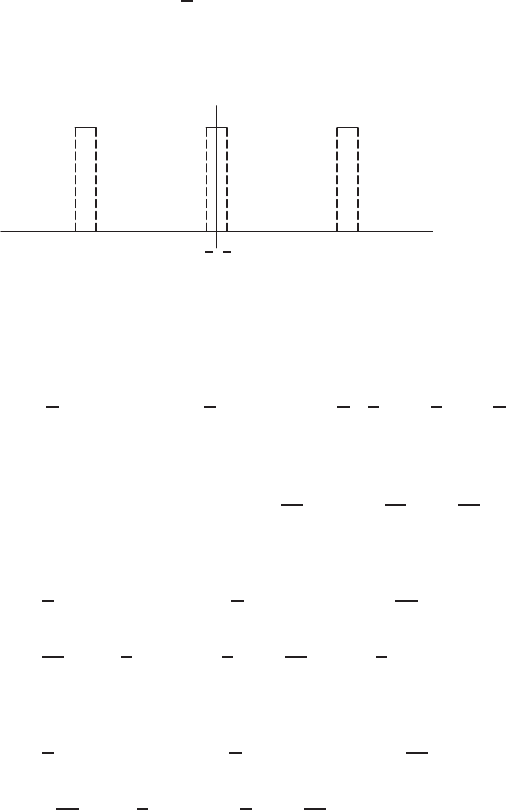
986 Chapter Ten /SOLUTIONS
Now, integrate term-by-term on the interval [−π, π]to get
Zπ
−π
f(x) sin mx dx =Zπ
−π a0sin mx +∞
X
k=1
akcos kx sin mx +∞
X
k=1
bksin kx sin mx!dx
=a0Zπ
−π
sin mx dx +∞
X
k=1 akZπ
−π
cos kx sin mx dx
+∞
X
k=1bkZπ
−π
sin kx sin mx dx.
Since mis a positive integer, we know that the first term of the above expression is zero (because Rπ
−πsin mx dx = 0).
Since Rπ
−πcos kx sin mx dx = 0, we know that everything in the first infinite sum is zero. Since Rπ
−πsin kx sin mx dx =
0where k6=m, the second infinite sum reduces down to the case where k=mso
Zπ
−π
f(x) sin mx dx =bmZπ
−π
sin mx sin mx dx =bmπ.
Divide by πto get
bm=1
πZπ
−π
f(x) sin mx dx.
22. (a) See Figure 10.27.
−3π−2π−π−1
2
1
2
π2π3π
1
x
f(x)
Figure 10.27
The energy of the pulse train fis
E=1
πZπ
−π
(f(x))2dx =1
πZ1/2
−1/2
12dx =1
π1
2−−1
2=1
π.
Next, find the Fourier coefficients:
a0=average value of fon [−π, π] = 1
2π(Area) = 1
2π(1) = 1
2π,
ak=1
πZπ
−π
f(x) cos kx dx =1
πZ1/2
−1/2
cos kx dx =1
kπ sin kx
1/2
−1/2
=1
kπ sin k
2−sin −k
2=1
kπ 2 sin k
2,
bk=1
πZπ
−π
f(x) sin kx dx =1
πZ1/2
−1/2
sin kx dx =−1
kπ cos kx
1/2
−1/2
=−1
kπ cos k
2−cos −k
2=1
kπ (0) = 0.
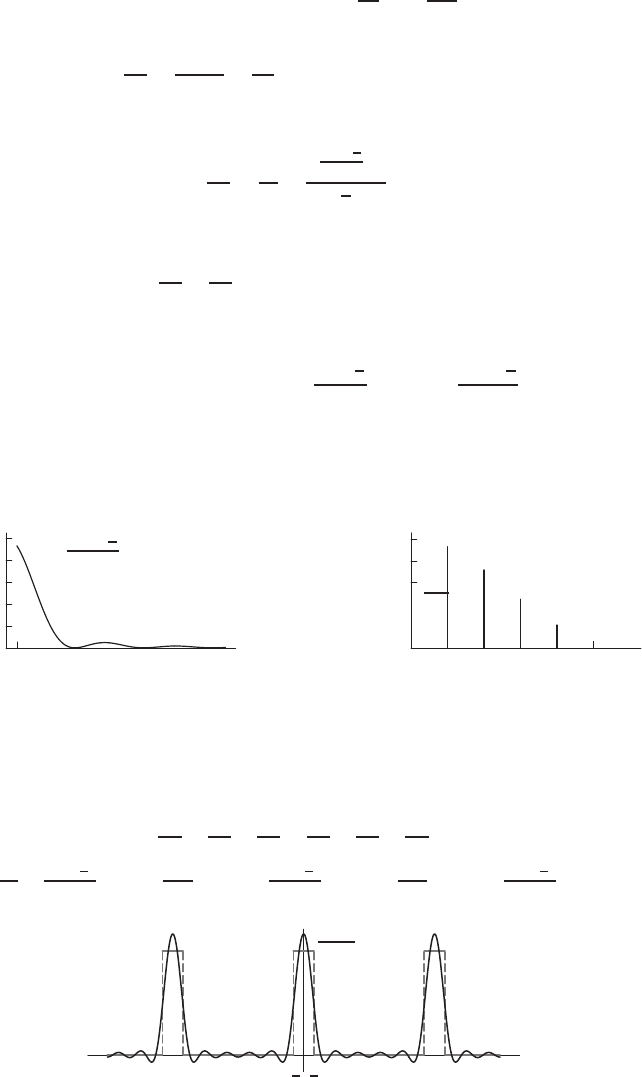
10.5 SOLUTIONS 987
The energy of fcontained in the constant term is
A2
0= 2a2
0= 2 1
2π2
=1
2π2
which is
A2
0
E=1/2π2
1/π =1
2π≈0.159155 = 15.9155% of the total.
The fraction of energy contained in the first harmonic is
A2
1
E=a2
1
E=2 sin 1
2
π2
1
π≈0.292653.
The fraction of energy contained in both the constant term and the first harmonic together is
A2
0
E+A2
1
E≈0.159155 + 0.292653 = 0.451808%.
(b) The formula for the energy of the kth harmonic is
A2
k=a2
k+b2
k=2 sin k
2
kπ 2
+ 02=4 sin2k
2
k2π2.
By graphing it as a continuous function for k≥1, we see its overall behavior as kgets larger. See Figure 10.28. The
energy spectrum for the first five terms is graphed below as well in Figure 10.29.
1 5 10 15 20
0.02
0.04
0.06
0.08
0.1
k
y
y=4 sin2k
2
k2π2
Figure 10.28
1 2 3 4 5
1
2π2
0.06
0.08
0.1
k
A2
k
0
Figure 10.29
(c) The constant term and the first five harmonics are needed to capture 90% of the energy off. This was determined by
adding the fractions of energy of fcontained in each harmonic until the sum reached at least 90%of the total energy
of f:
A2
0
E+A2
1
E+A2
2
E+A2
3
E+A2
4
E+A2
5
E≈90.1995%.
(d) F5(x) = 1
2π+2 sin( 1
2)
πcos x+sin 1
πcos 2x+2 sin( 3
2)
3πcos 3x+sin 2
2πcos 4x+2 sin( 5
2)
5πcos 5x. See Figure 10.30.
−3π−2π−π−1
2
1
2
π2π3π
1
x
f(x)
✛F5(x)
Figure 10.30
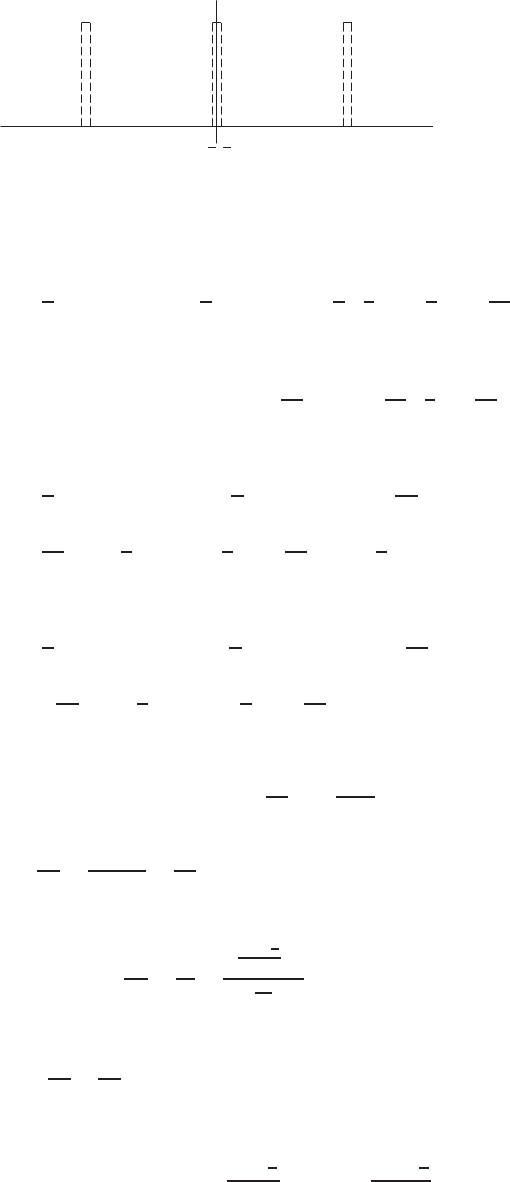
988 Chapter Ten /SOLUTIONS
23. (a) See Figure 10.31.
−3π−2π−π−1
5
1
5
π2π3π
1
x
f(x)
Figure 10.31
The energy of the pulse train fis
E=1
πZπ
−π
(f(x))2dx =1
πZ1/5
−1/5
12dx=1
π1
5−−1
5=2
5π.
Next, find the Fourier coefficients:
a0=average value of fon [−π, π] = 1
2π(Area) = 1
2π2
5=1
5π,
ak=1
πZπ
−π
f(x) cos kx dx =1
πZ1/5
−1/5
cos kx dx =1
kπ sin kx
1/5
−1/5
=1
kπ sin k
5−sin −k
5=1
kπ 2 sin k
5,
bk=1
πZπ
−π
f(x) sin kx dx =1
πZ1/5
−1/5
sin kx dx =−1
kπ cos kx
1/5
−1/5
=−1
kπ cos k
5−cos −k
5=1
kπ (0) = 0.
The energy of fcontained in the constant term is
A2
0= 2a2
0= 2 1
5π2
=2
25π2
which is
A2
0
E=2/25π2
2/5π=1
5π≈0.063662 = 6.3662% of the total.
The fraction of energy contained in the first harmonic is
A2
1
E=a2
1
E=2 sin 1
5
π2
2
5π≈0.12563.
The fraction of energy contained in both the constant term and the first harmonic together is
A2
0
E+A2
1
E≈0.06366 + 0.12563 = 0.18929 = 18.929%.
(b) The formula for the energy of the kth harmonic is
A2
k=a2
k+b2
k=2 sin k
5
kπ 2
+ 02=4 sin2k
5
k2π2.
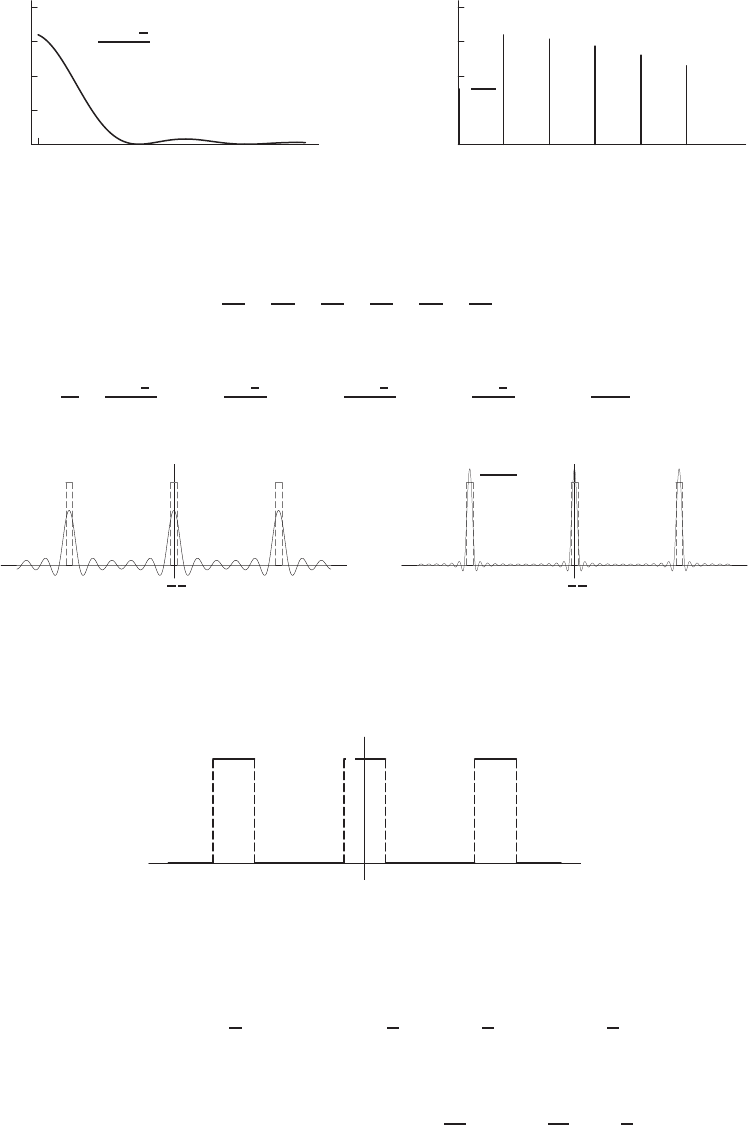
10.5 SOLUTIONS 989
By graphing this formula as a continuous function for k≥1, we see its overall behavior as kgets larger in Fig-
ure 10.32. The energy spectrum for the first five terms is shown in Figure 10.33.
1 10 20 30 40
0.005
0.01
0.015
0.02
k
y
y=4 sin2k
5
k2π2
Figure 10.32
12345
2
52π
0.005
0.01
0.015
0.02
k
A2
k
0
Figure 10.33
(c) The constant term and the first five harmonics contain
A2
0
E+A2
1
E+A2
2
E+A2
3
E+A2
4
E+A2
5
E≈61.5255%
of the total energy of f.
(d) The fifth Fourier approximation to fis
F5(x) = 1
5π+2 sin( 1
5)
πcos x+sin( 2
5)
πcos 2x+2 sin( 3
5)
3πcos 3x+sin( 4
5)
2πcos 4x+2 sin 1
5πcos 5x. See Figure 10.34.
For comparison, Figure 10.35 shows the thirteenth Fourier approximation to f.
−3π−2π−π−1
5
1
5
π2π3π
1
x
f(x)
F5(x)
Figure 10.34
−3π−2π−π−1
5
1
5
π2π3π
1
x
✛F13(x)
Figure 10.35
24. (a) See Figure 10.36.
−3π−2π−π−1 1 π2π3π
1
x
f(x)
Figure 10.36
The energy of the pulse train fis
E=1
πZπ
−π
(f(x))2dx =1
πZ1
−1
12=1
π(1 −(−1)) = 2
π.
Next, find the Fourier coefficients:
a0=average value of fon [−π, π] = 1
2π(Area) = 1
2π(2) = 1
π,
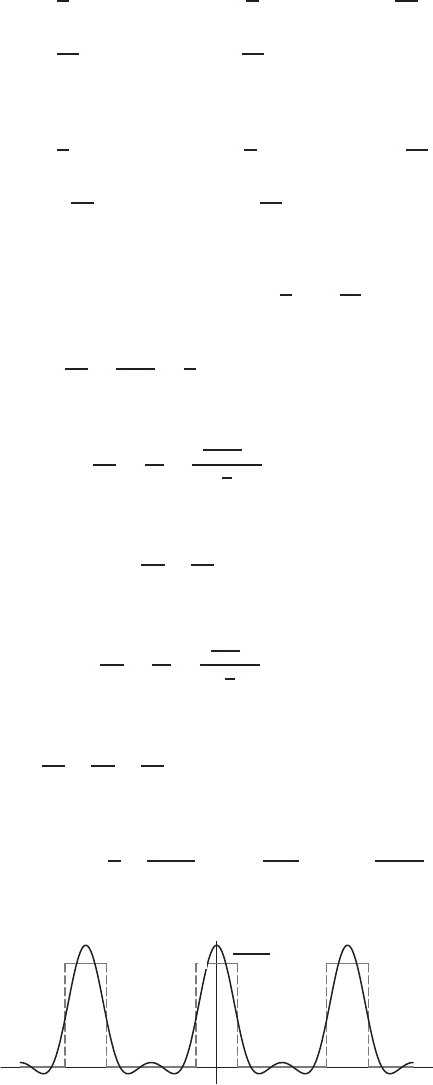
990 Chapter Ten /SOLUTIONS
ak=1
πZπ
−π
f(x) cos kx dx =1
πZ1
−1
cos kx dx =1
kπ sin kx
1
−1
=1
kπ (sin k−sin(−k)) = 1
kπ (2 sin k),
bk=1
πZπ
−π
f(x)sin kx dx =1
πZ1
−1
sin kx dx =−1
kπ cos kx
1
−1
=−1
kπ (cos k−cos(−k)) = 1
kπ (0) = 0.
The energy of fcontained in the constant term is
A2
0= 2a2
0= 2 1
π2
=2
π2
which is
A2
0
E=2/π2
2/π =1
π≈0.3183 = 31.83% of the total.
The fraction of energy contained in the first harmonic is
A2
1
E=a2
1
E=2 sin 1
π2
2
π≈0.4508 = 45.08%.
The fraction of energy contained in both the constant term and the first harmonic together is
A2
0
E+A2
1
E≈0.7691 = 76.91%.
(b) The fraction of energy contained in the second harmonic is
A2
2
E=a2
2
E=sin 2
π2
2
π≈0.1316 = 13.16%
so the fraction of energy contained in the constant term and first two harmonics is
A2
0
E+A2
1
E+A2
2
E≈0.7691 + 0.1316 = 0.9007 = 90.07%.
Therefore, the constant term and the first two harmonics are needed to capture 90% of the energy of f.
(c)
F3(x) = 1
π+2 sin 1
πcos x+sin 2
πcos 2x+2 sin 3
3πcos 3x.
See Figure 10.37.
−3π−2π−π−1 1 π2π3π
1
x
✛F3(x)
f(x)
Figure 10.37
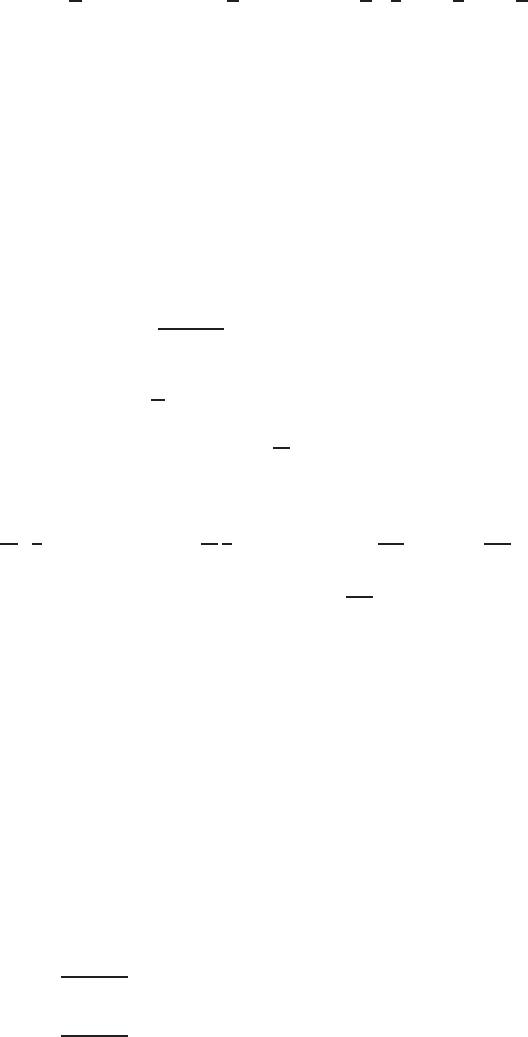
10.5 SOLUTIONS 991
25. As cgets closer and closer to 0, the energy of the pulse train will also approach 0, since
E=1
πZπ
−π
(f(x))2dx =1
πZc/2
−c/2
12dx =1
πc
2−−c
2=c
π.
The energy spectrum shows the relative distribution of the energy of famong its harmonics. The fraction of energy carried
by each harmonic gets smaller as cgets closer to 0, as shown by comparing the kth terms of the Fourier series for pulse
trains with c= 2,1,0.4. For instance, notice that the fraction or percentage of energy carried by the constant term gets
smaller as cgets smaller; the same is true for the energy carried by the first harmonic.
If each harmonic contributes less energy, then more harmonics are needed to capture a fixed percentage of energy.
For example, if c= 2, only the constant term and the first two harmonics are needed to capture 90%of the total energy of
that pulse train. If c= 1, the constant term and the first five harmonics are needed to get 90%of the energy of that pulse
train. If c= 0.4, the constant term and the first thirteen harmonics are needed to get 90%of the energy of that pulse train.
This means that more harmonics, or more terms in the series, are needed to get an accurate approximation. Compare the
graphs of the fifth and thirteenth Fourier approximations of fin Problem 23.
26. By formula II-11 of the integral table,
Zπ
−π
cos kx cos mx dx =1
m2−k2mcos(kx) sin(mx)−ksin(kx) cos(mx)
π
−π
.
Again, since sin(nπ) = 0 for any integer n, it is easy to see that this expression is simply 0.
27. We make the substitution u=mx,dx =1
mdu. Then
Zπ
−π
cos2mx dx =1
mZu=mπ
u=−mπ
cos2u du.
By Formula IV-18 of the integral table, this equals
1
m1
2cos usin u
mπ
−mπ
+1
m
1
2Zmπ
−mπ
1du = 0 + 1
2mu
mπ
−mπ
=1
2mu
mπ
−mπ
=1
2m(2mπ) = π.
28. The easiest way to do this is to use Problem 27.
Zπ
−π
sin2mx dx =Zπ
−π
(1 −cos2mx)dx =Zπ
−π
dx −Zπ
−π
cos2mx dx
= 2π−πusing Problem 27
=π.
29. By formula II-12 of the integral table,
Zπ
−π
sin kx cos mx dx
=1
m2−k2msin(kx) sin(mx) + kcos(kx) cos(mx)
π
−π
=1
m2−k2msin(kπ) sin(mπ) + kcos(kπ) cos(mπ)
−msin(−kπ) sin(−mπ)−kcos(−kπ) cos(−mπ).
Since kand mare positive integers, sin(kπ) = sin(mπ) = sin(−kπ) = sin(−mπ) = 0.Also, cos(kπ) = cos(−kπ)
since cos xis even. Thus this expression reduces to 0. [Note: since sin kx cos mx is odd, so Rπ
−πsin kx cos mx dx must
be 0.]
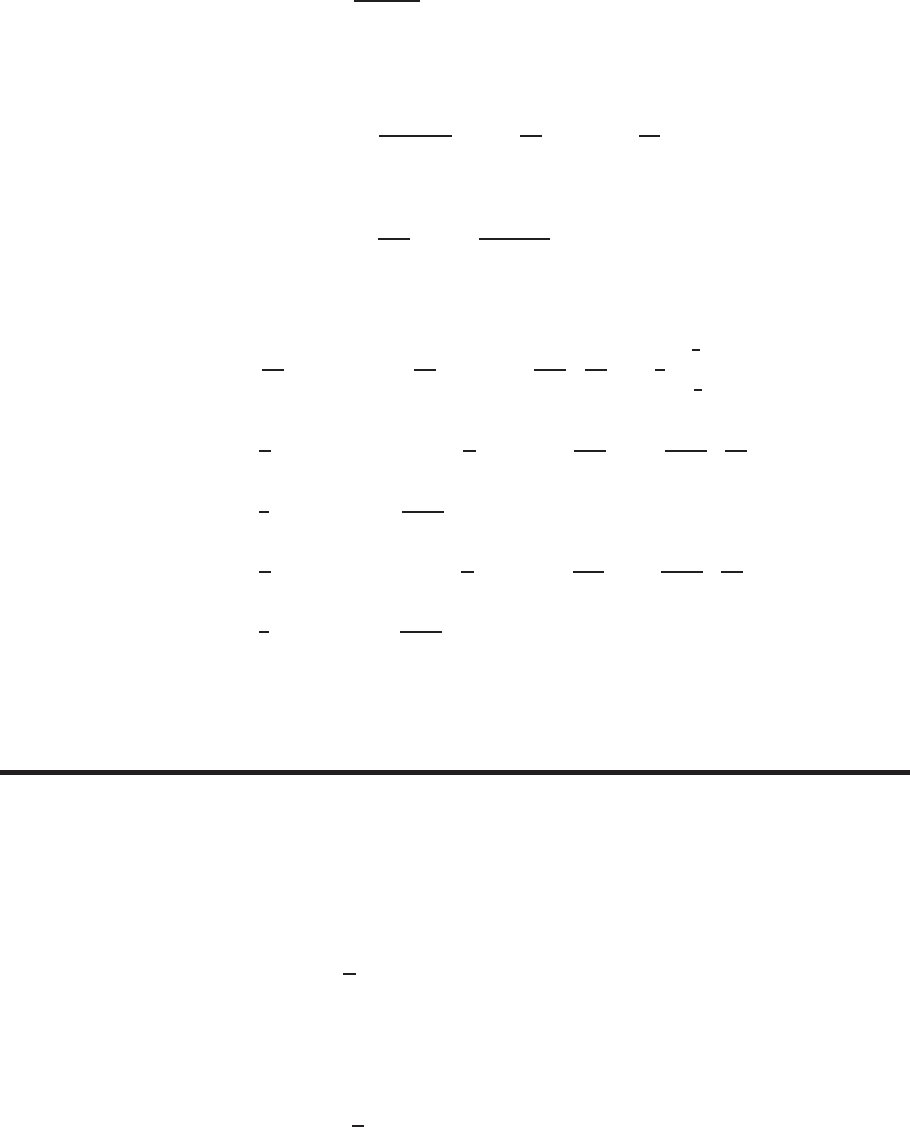
992 Chapter Ten /SOLUTIONS
30. Using formula II-10 in the integral table,
Zπ
−π
sin kx sin mx dx =1
m2−k2kcos(kx) sin(mx)−msin(kx) cos(mx)
π
−π
.
Again, since sin(nπ) = 0 for all integers n, this expression reduces to 0.
31. (a) To show that g(t)is periodic with period 2π, we calculate
g(t+ 2π) = fb(t+2π)
2π=fbt
2π+b=fbt
2π=g(t).
Since g(t+ 2π) = g(t)for all t, we know that g(t)is periodic with period 2π. In addition
g2πx
b=fb(2πx/b)
2π=f(x).
(b) We make the change of variable t= 2πx/b,dt = (2π/b)dx in the usual formulas for the Fourier coefficients of
g(t), as follows:
a0=1
2πZπ
t=−π
g(t)dt =1
2πZb/2
x=−b/2
g2πx
b2π
bdx =1
bZb
2
−b
2
f(x)dx
ak=1
πZπ
t=−π
g(t) cos(kt)dt =1
πZb/2
x=−b/2
g2πx
bcos 2πkx
b2π
bdx
=2
bZb/2
−b/2
f(x) cos 2πkx
bdx
bk=1
πZπ
t=−π
g(t) sin(kt)dt =1
πZb/2
x=−b/2
g2πx
bsin 2πkx
b2π
bdx
=2
bZb/2
−b/2
f(x) sin 2πkx
bdx
(c) By part (a), the Fourier series for f(x)can be obtained by substituting t= 2πx/b into the Fourier series for g(t)
which was found in part (b).
Strengthen Your Understanding
32. Since sin(kx)is an odd function and cos(mx)is an even function, we know sin(kx) cos(mx)is an odd function. Hence
Rπ
−πsin(kx) cos(mx)dx is equal to 0.
33. Unlike Taylor series, Fourier series are good global approximations rather than local ones. Thus, a0is the average of f(x)
on the interval of approximation.
34. Since cos kx is even for each k > 0, we expect fto be even if there are no sine terms. So let fbe any even function with
period 2π. Then the coefficients of the sine terms are
bk=1
πZπ
−π
f(x) sin(kx)dx = 0,for k > 0,
since f(x) sin kx is odd. For example, we could let f(x) = cos x.
35. Since sin kx is an odd function for all k > 0, we expect fto be odd if there are no cosine terms. So let fbe any odd
function.with period 2π. Then the coefficients of the cosine terms are
ak=1
πZπ
−π
f(x) cos(kx)dx = 0,for k≥1,
since f(x) cos kx is odd. For example, we could let f(x) = sin x.
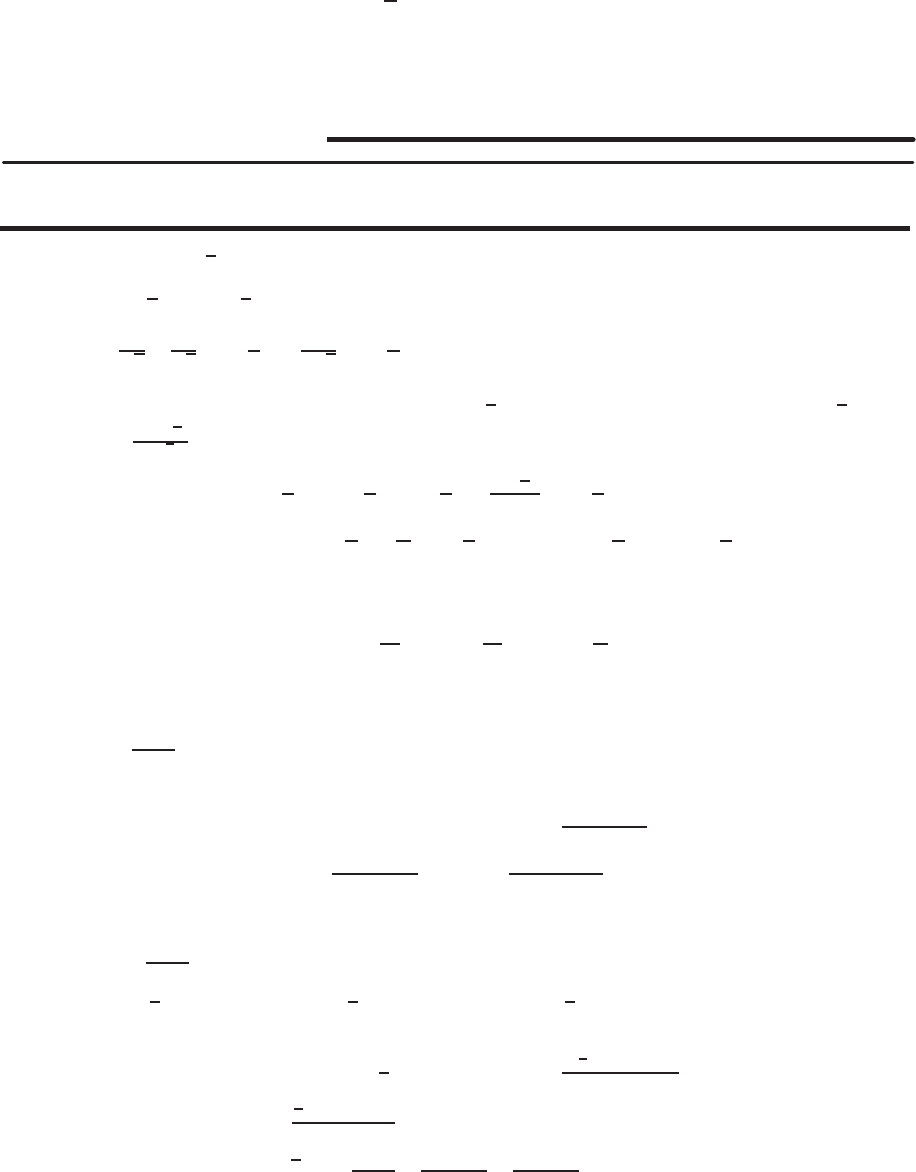
SOLUTIONS to Review Problems for Chapter Ten 993
36. True. Since fis even, f(x) sin(mx)is odd for any m, so
bm=1
πZπ
−π
f(x)sin x(mx)dx = 0.
37. (b). The graph describes an even function, which eliminates (a) and (c). The Fourier series for (d) would have values near
πfor xclose to 0.
Solutions for Chapter 10 Review
Exercises
1. ex≈1 + e(x−1) + e
2(x−1)2
2. ln x≈ln 2 + 1
2(x−2) −1
8(x−2)2
3. sin x≈ − 1
√2+1
√2x+π
4+1
2√2x+π
42
4. Differentiating f(x) = tan x, we get f′(x) = 1/cos2x,f′′(x) = 2 sin x/ cos3x.
Since tan(π/4) = 1,cos(π/4) = sin(π/4) = 1/√2, we have f(π/4) = 1,f′(π/4) = 1/(1/√2)2= 2,
f′′(π/4) = 2(1/√2)
(1/√2)3= 4, so
tan x≈fπ
4+f′π
4x−π
4+f′′(π
4)
2! x−π
42
= 1 + 2 x−π
4+4
2! x−π
42
=1 + 2 x−π
4+ 2 x−π
42
.
5.f′(x) = 3x2+ 14x−5,f′′(x) = 6x+ 14,f′′′(x) = 6. The Taylor polynomial about x= 1 is
P3(x) = 4 + 12
1! (x−1) + 20
2! (x−1)2+6
3! (x−1)3
= 4 + 12(x−1) + 10(x−1)2+ (x−1)3.
Notice that if you multiply out and collect terms in P3(x), you will get f(x)back.
6. Let f(x) = 1
1−x= (1 −x)−1. Then f′(x) = (1 −x)−2,f′′(x) = 2(1 −x)−3,f′′′(x) = 6(1 −x)−4, and f(4)(x) =
24(1 −x)−5. The Taylor polynomial of degree 4 about a= 2 is thus
P4(x) = (1 −2)−1+ (1 −2)−2(x−2) + 2(1 −2)−3
2! (x−2)2
+6(1 −2)−4
3! (x−2)3+24(1 −2)−5
4! (x−4)4
=−1 + (x−2) −(x−2)2+ (x−2)3−(x−2)4.
7. Let f(x) = √1 + x= (1 + x)1/2.
Then f′(x) = 1
2(1 + x)−1/2,f′′(x) = −1
4(1 + x)−3/2, and f′′′(x) = 3
8(1 + x)−5/2.The Taylor polynomial of degree
three about x= 1 is thus
P3(x) = (1 + 1)1/2+1
2(1 + 1)−1/2(x−1) + −1
4(1 + 1)−3/2
2! (x−1)2
+
3
8(1 + 1)−5/2
3! (x−1)3
=√21 + x−1
4−(x−1)2
32 +(x−1)3
128 .
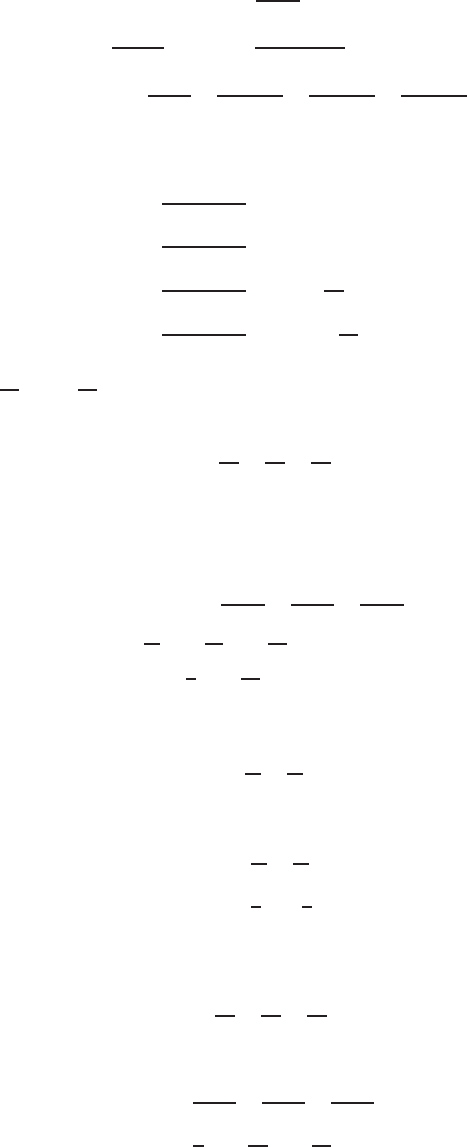
994 Chapter Ten /SOLUTIONS
8. Let f(x) = ln x. Then f′(x) = x−1,f′′(x) = −x−2,f′′′(x) = 2x−3, and f(4)(x) = −3·2x−4.
So,
P4(x) = ln 2 + 2−1(x−2) + −2−2
2! (x−2)2
+2·2−3
3! (x−2)3+−3·2·2−4
4! (x−2)4
= ln 2 + x−2
2−(x−2)2
8+(x−2)3
24 −(x−2)4
64 .
9. The first four nonzero terms of P7are given by:
i= 1 : (−1)1+131
(1 −1)! x2·1−1= 3x
i= 2 : (−1)2+132
(2 −1)! x2·2−1=−9x3
i= 3 : (−1)3+133
(3 −1)! x2·3−1=27
2·x5
i= 4 : (−1)4+134
(4 −1)! x2·4−1=−27
2·x7.
Thus, P7= 3x−9x3+27
2·x5−27
2·x7.
10. We know that
cos x= 1 −x2
2! +x4
4! −x6
6! +···
Therefore, using the hint,
f(x) = 0.5(1 + cos 2x)
= 0.5 + 0.5(1 −(2x)2
2! +(2x)4
4! −(2x)6
6! +···
= 1 −2
2! x2+23
4! x4−25
6! x6+···
= 1 −x2+1
3x4−2
45 x6+···
11. We multiply the series for etby t2. Since
et= 1 + t+t2
2! +t3
3! +···,
multiplying by t2gives
t2et=t2+t3+t4
2! +t5
3! +···
=t2+t3+1
2t4+1
6t5+···.
12. We substitute 3yinto the series for cos x. Since
cos x= 1 −x2
2! +x4
4! −x6
6! +···,
substituting x= 3ygives
cos(3y) = 1 −(3y)2
2! +(3y)4
4! −(3y)6
6! +···
= 1 −9
2y2+27
8y4−81
80 y6+···.
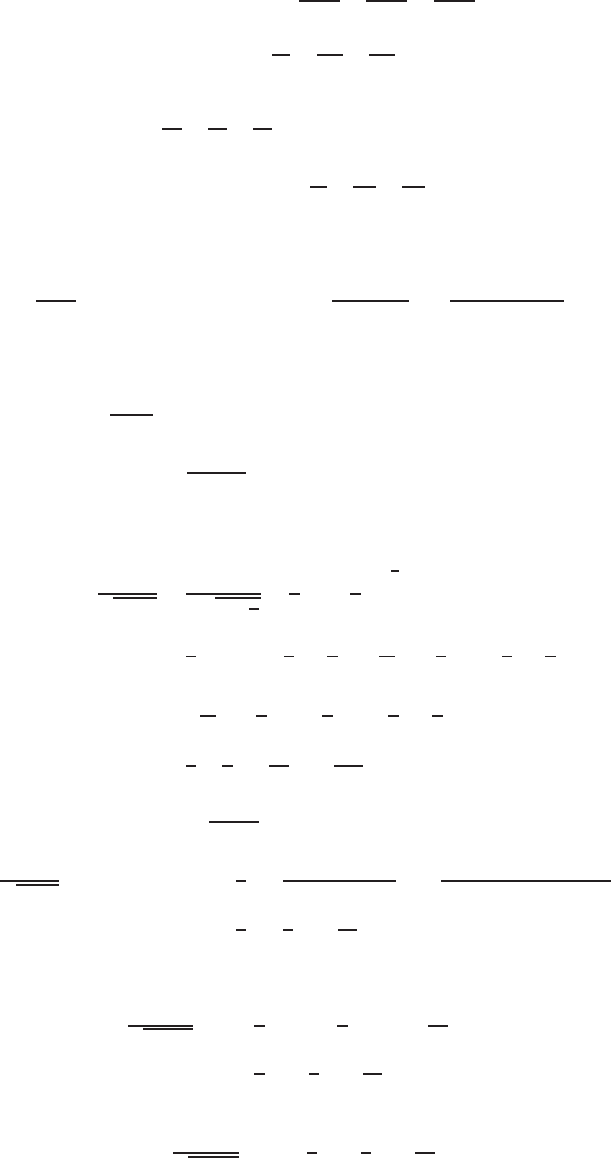
SOLUTIONS to Review Problems for Chapter Ten 995
13.
θ2cos θ2=θ21−(θ2)2
2! +(θ2)4
4! −(θ2)6
6! +···
=θ2−θ6
2! +θ10
4! −θ14
6! +···
14. Substituting y=t2in sin y=y−y3
3! +y5
5! −y7
7! +···gives
sin t2=t2−t6
3! +t10
5! −t14
7! +···
15.
t
1 + t=t(1 + t)−1=t1 + (−1)t+(−1)(−2)
2! t2+(−1)(−2)(−3)
3! t3+···
=t−t2+t3−t4+···
16. Substituting y=−4z2into 1
1 + y= 1 −y+y2−y3+··· gives
1
1−4z2= 1 + 4z2+ 16z4+ 64z6+···
17.
1
√4−x=1
2p1−x
2
=1
21−x
2−1
2
=1
21−−1
2x
2+1
2! −1
2−3
2x
22
−1
3! −1
2−3
2−5
2x
23
+···
=1
2+1
8x+3
64 x2+5
256 x3+···
18. We use the binomial series to expand 1/√1−z2and multiply by z2. Since
1
√1 + x= (1 + x)−1/2= 1 −1
2x+(−1/2)(−3/2)
2! x2+(−1/2)(−3/2)(−5/2)
3! x3+···
= 1 −1
2x+3
8x2−5
16 x3+···.
Substituting x=−z2gives
z2
√1−z2= 1 −1
2(−z2) + 3
8(−z2)2−5
16 (−z2)3+···
= 1 + 1
2z2+3
8z4+5
16 z6+···.
Multiplying by z2, we have
z2
√1−z2=z2+1
2z4+3
8z6+5
16 z8+···.
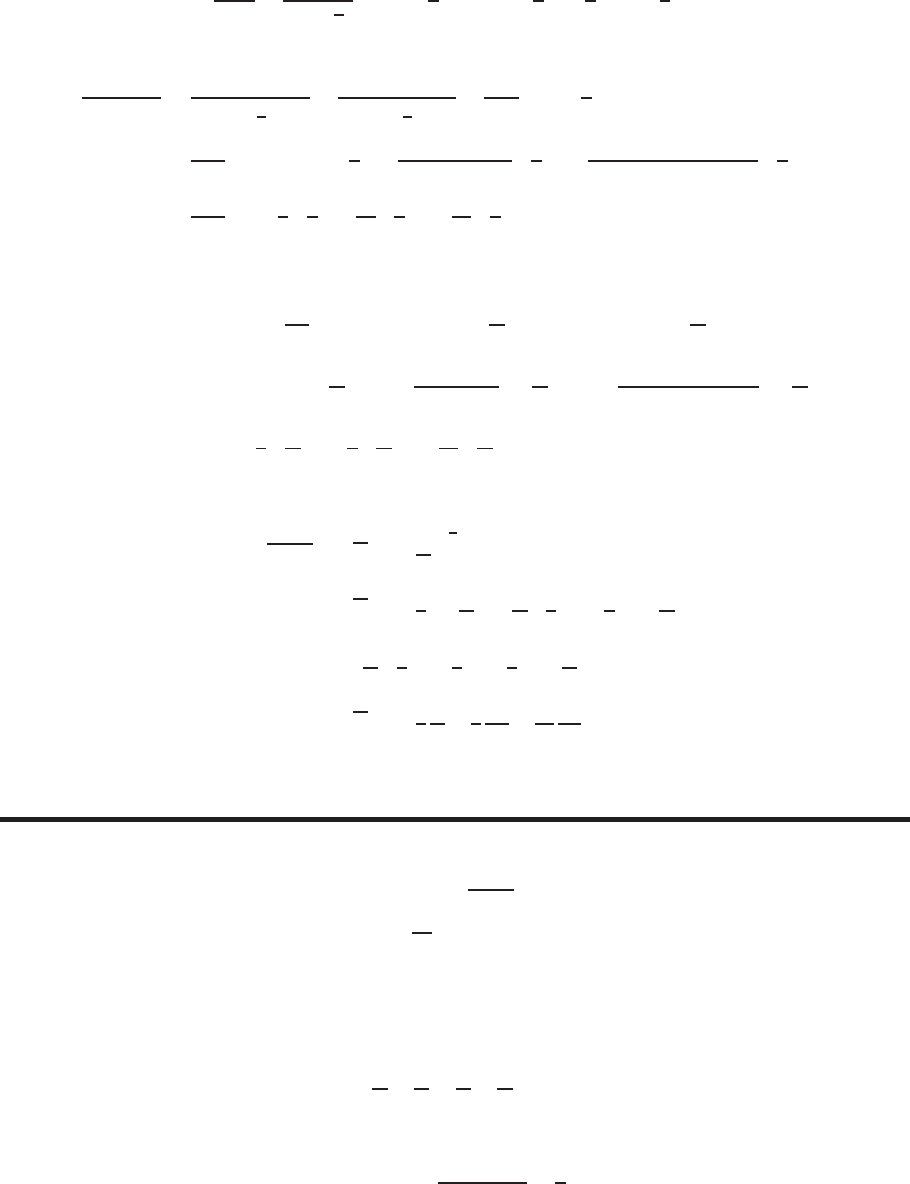
996 Chapter Ten /SOLUTIONS
19.
a
a+b=a
a(1 + b
a)=1 + b
a−1
= 1 −b
a+b
a2
−b
a3
+···
20. Using the binomial expansion for (1 + x)−3/2with x=r/a:
1
(a+r)3/2=1
a+ar
a3/2=1
a1 + r
a3/2=1
a3/21 + r
a−3/2
=1
a3/21 + (−3/2) r
a+(−3/2)(−5/2)
2! r
a2
+(−3/2)(−5/2)(−7/2)
3! r
a3
+···
=1
a3/21−3
2r
a+15
8r
a2
−35
16 r
a3
+···.
21. Using the binomial expansion for (1 + x)3/2with x=y/B.
(B2+y2)3/2=B2+B2y2
B23/2
=B21 + y
B23/2
=B31 + y
B23/2
=B3 1 + (3/2) y
B21
+(3/2)(1/2)
2! y
B22
+(3/2)(1/2)(−1/2)
3! y
B23
···!
=B31 + 3
2y
B2
+3
8y
B4
−1
16 y
B6
···.
22.
√R−r=√R1−r
R1
2
=√R1 + 1
2−r
R+1
2! 1
2−1
2−r
R2
+1
3! 1
2−1
2−3
2−r
R3
+···
=√R1−1
2
r
R−1
8
r2
R2−1
16
r3
R3− ···
Problems
23. The second degree Taylor polynomial for f(x)around x= 3 is
f(x)≈f(3) + f′(3)(x−3) + f′′(3)
2! (x−3)2
= 1 + 5(x−3) −10
2! (x−3)2= 1 + 5(x−3) −5(x−3)2.
Substituting x= 3.1, we get
f(3.1) ≈1 + 5(3.1−3) −5(3.1−3)2= 1 + 5(0.1) −5(0.01) = 1.45.
24. Factoring out a 3, we see
31 + 1 + 1
2! +1
3! +1
4! +1
5! +···= 3e1= 3e.
25. Infinite geometric series with a= 1,x=−1/3, so
Sum =1
1−(−1/3) =3
4.
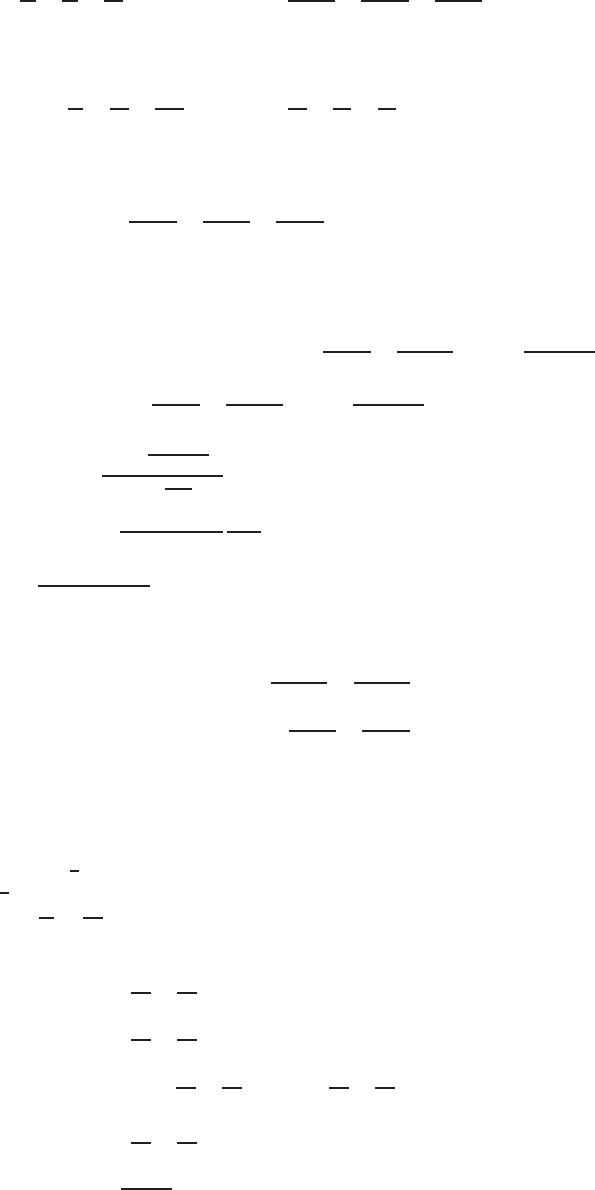
SOLUTIONS to Review Problems for Chapter Ten 997
26. This is the series for exwith x=−2substituted. Thus
1−2 + 4
2! −8
3! +16
4! +···= 1 + (−2) + (−2)2
2! +(−2)3
3! +(−2)4
4! +···=e−2.
27. This is the series for sin xwith x= 2 substituted. Thus
2−8
3! +32
5! −128
7! +···= 2 −23
3! +25
5! −27
7! +···= sin 2.
28. Factoring out a 0.1, we see
0.10.1−(0.1)3
3! +(0.1)5
5! −(0.1)7
7! +···= 0.1 sin(0.1).
29. (a) Factoring out 7(1.02)3and using the formula for the sum of a finite geometric series with a= 7(1.02)3and r=
1/1.02, we see
Sum = 7(1.02)3+ 7(1.02)2+ 7(1.02) + 7 + 7
(1.02) +7
(1.02)3+···+7
(1.02)100
= 7(1.02)31 + 1
(1.02) +1
(1.02)2+···+1
(1.02)103
= 7(1.02)31−1
(1.02)104
1−1
1.02
= 7(1.02)3(1.02)104 −1
(1.02)104
1.02
0.02
=7(1.02104 −1)
0.02(1.02)100 .
(b) Using the Taylor expansion for exwith x= (0.1)2, we see
Sum = 7 + 7(0.1)2+7(0.1)4
2! +7(0.1)6
3! +···
= 7 1 + (0.1)2+(0.1)4
2! +(0.1)6
3! +···
= 7e(0.1)2
= 7e0.01.
30. Let Cnbe the coefficient of the nth term in the series. C1=f′(0)/1!, so f′(0) = 1!C1= 1 ·1 = 1.
Similarly, f′′(0) = 2!C2= 2! ·1
2= 1;
f′′′(0) = 3!C3= 3! ·1
3= 2! = 2;
f(10)(0) = 10!C10 = 10! ·1
10 =10!
10 = 9! = 362880.
31. Write out series expansions about x= 0, and compare the first few terms:
sin x=x−x3
3! +x5
5! +···
ln(1 + x) = x−x2
2+x3
3− ···
1−cos x= 1 −1−x2
2! +x4
4! − ···=x2
2! −x4
4! +···
ex−1 = x+x2
2! +x3
3! +···
arctan x=Zdx
1 + x2=Z(1 −x2+x4− ···)dx
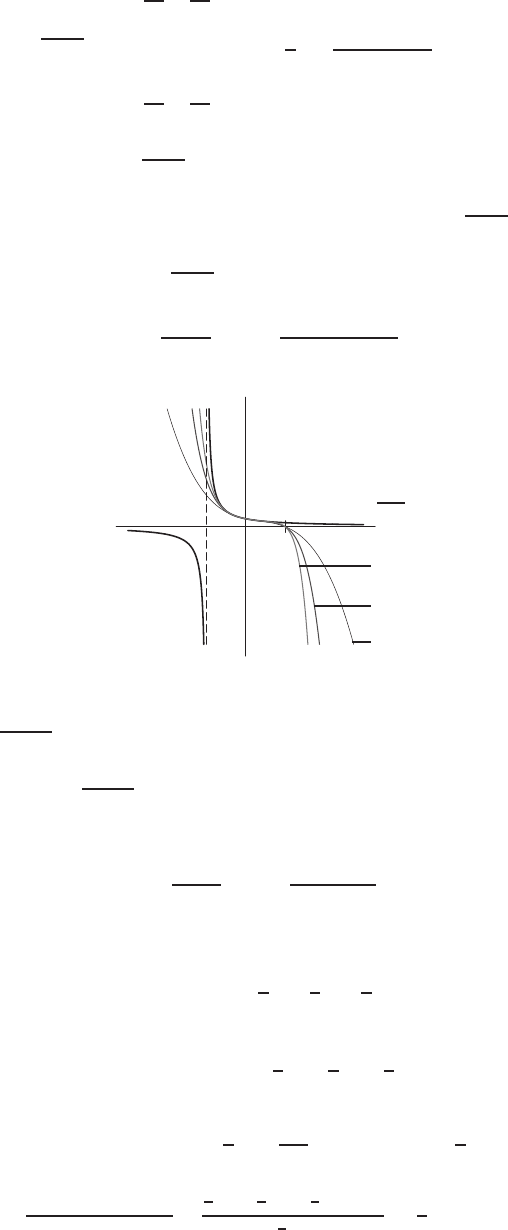
998 Chapter Ten /SOLUTIONS
=x−x3
3+x5
5+··· (note that the arbitrary constant is 0)
x√1−x=x(1 −x)1/2=x1−1
2x+(1/2)(−1/2)
2x2+···
=x−x2
2+x3
8+···
So, considering just the first term or two (since we are interested in small x)
1−cos x < x√1−x < ln(1 + x)<arctan x < sin x < x < ex−1.
32. The graph in Figure 10.38 suggests that the Taylor polynomials converge to f(x) = 1
1 + xon the interval (−1,1). The
Taylor expansion is
f(x) = 1
1 + x= 1 −x+x2−x3+x4− ···,
so the ratio test gives
lim
n→∞ |an+1|
|an|= lim
n→∞ |(−1)n+1xn+1|
|(−1)nxn|=|x|.
Thus, the series converges if |x|<1; that is −1< x < 1.
✛P3(x)
✛P5(x)
✛P7(x)
−1 1
f(x) = 1
1+x
x
Figure 10.38
33. The Taylor series of 1
1−2xaround x= 0 is
1
1−2x= 1 + 2x+ (2x)2+ (2x)3+···=∞
X
k=0
(2x)k.
To find the radius of convergence, we apply the ratio test with ak= (2x)k.
lim
k→∞ |ak+1|
|ak|= lim
k→∞
2k+1|x|k+1
2k|x|k= 2|x|.
Hence the radius of convergence is R= 1/2.
34. First we use the Taylor series expansion for ln(1 + t),
ln(1 + t) = t−1
2t2+1
3t3−1
4t4+···
to find the Taylor series expansion of ln(1 + x+x2)by putting t=x+x2. We get
ln(1 + x+x2) = x+1
2x2−2
3x3+1
4x4+···.
Next we use the Taylor series for sin xto get
sin2x= (sin x)2= (x−1
6x3+1
120 x5− ···)2=x2−1
3x4+···.
Finally,
ln(1 + x+x2)−x
sin2x=
1
2x2−2
3x3+1
4x4+···
x2−1
3x4+··· →1
2,as x→0.
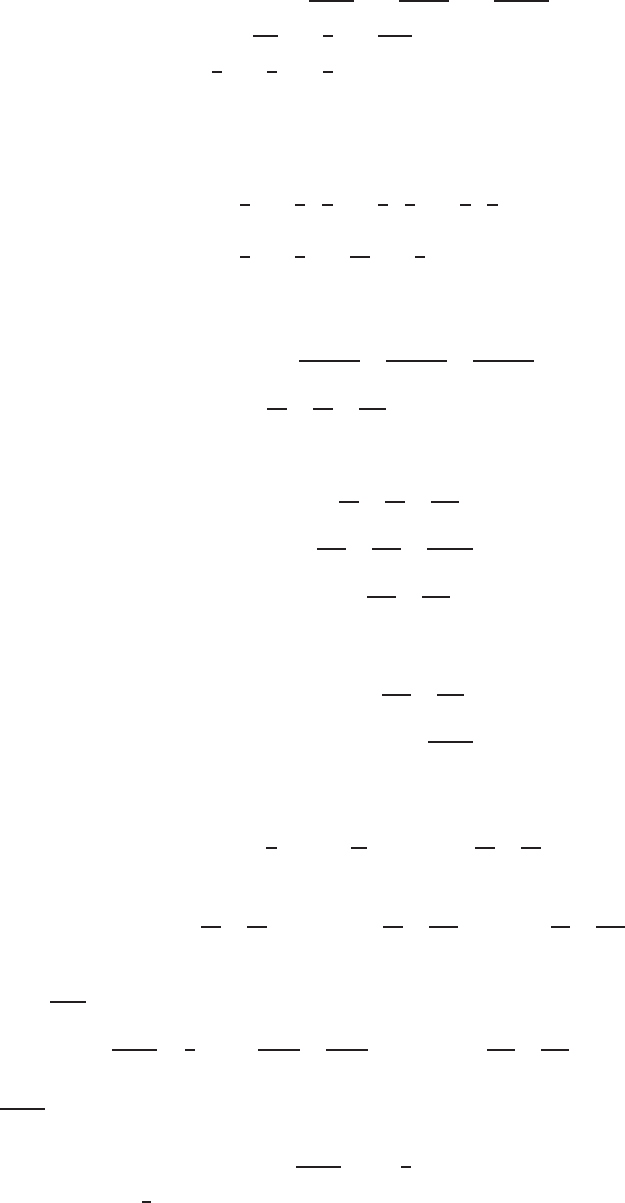
SOLUTIONS to Review Problems for Chapter Ten 999
35. The fourth-degree Taylor polynomial for fat x= 0 is
P4(x) = f(0) + f′(0)x+f′′(0)
2x2+f′′′(0)
6x3+f(4)(0)
24 x4
= 0 + 1x+−3
2x2+7
6x3+−15
24 x4
=x−3
2x2+7
6x3−5
8x4.
Thus,
Z0.6
0
f(x)dx ≈Z0.6
0
P4(x)dx
=1
2x2−3
2·1
3x3+7
6·1
4x4−5
8·1
5x5
0.6
0
=1
2x2−1
2x3+7
24 x4−1
8x5
0.6
0
= 0.10008.
36. (a) Using the Taylor series for ex, we have:
e−x3= 1 + −x3+−x32
2+−x33
6+−x34
24 +···
= 1 −x3+x6
2−x9
6+x12
24 +···.
(b) Using the Taylor polynomial of degree 12 from part (a), we have:
f′(x) = 1−x3+x6
2−x9
6+x12
24 +···′
=−3x2+6x5
2−9x8
6+12x11
24 +···
=−3x2+ 3x5−3x8
2+x11
2+···
f′′(x) = f′(x)′
=−3x2+3x5−3x8
2+x11
2+···′
=−6x+15x4−12x7+11x10
2+···.
37. We find the Taylor polynomial for cos(x2)by substituting into the series for cos x:
cos x2≈1−1
2x22+1
4! x24= 1 −x4
2+x8
24 .
This means that
Z1
0
cos x2dx ≈Z1
01−x4
2+x8
24 dx =x−x5
10 +x9
216
1
0
= 1 −1
10 +1
216 = 0.90463.
This is a very good estimate; the actual value (found using a computer) is 0.90452 ....
38. (a) The series for sin 2θ
θis
sin 2θ
θ=1
θ2θ−(2θ)3
3! +(2θ)5
5! − ···= 2 −4θ2
3+4θ4
15 − ···
so lim
θ→0
sin 2θ
θ= 2.
(b) Near θ= 0, we make the approximation
sin 2θ
θ≈2−4
3θ2
so the parabola is y= 2 −4
3θ2.
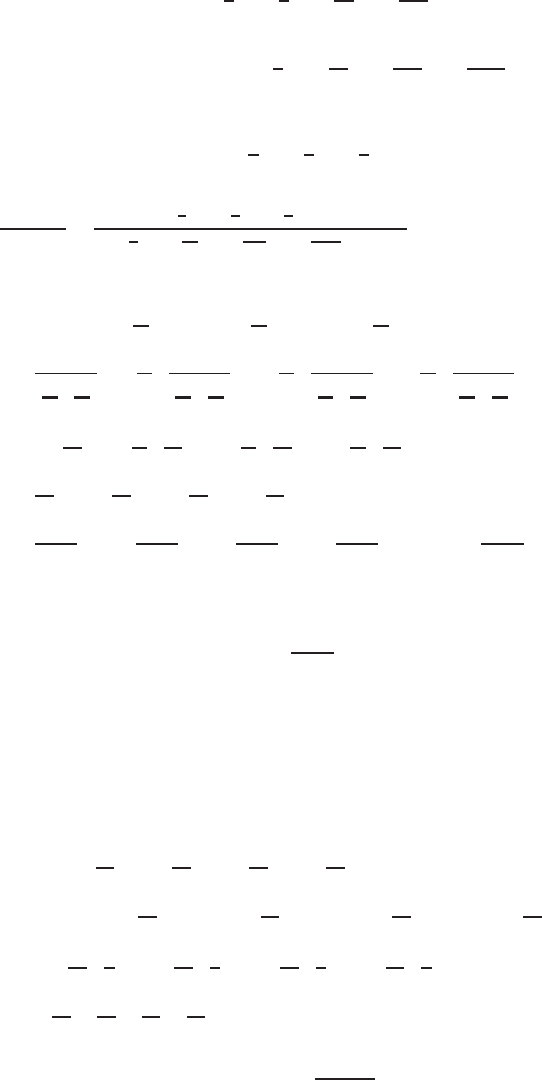
1000 Chapter Ten /SOLUTIONS
39. (a) Since R(1 −x2)−1/2dx = arcsin x, we use the Taylor series for (1 −x2)−1/2to find the Taylor series for arcsin x:
(1 −x2)−1/2= 1 + 1
2x2+3
8x4+5
16 x6+35
128 x8+···
so
arcsin x=Z(1 −x2)−1/2dx =x+1
6x3+3
40 x5+5
112 x7+35
1152 x9+···
(b) From Example 3 in Section 10.3, we know
arctan x=x−1
3x3+1
5x5−1
7x7+···
so that
arctan x
arcsin x=x−1
3x3+1
5x5−1
7x7+···
x+1
6x3+3
40 x5+5
112 x7+35
1152 x9+··· →1,as x→0.
40. (a) The Taylor series is given by
f(x) = f(0) + f′(0)x+1
2! ·f′′(0)x2+1
3! ·f′′′(0)x3+1
4! ·f(4)(0)x4+···
= 1 + (1 + 1)!
21
| {z }
f′(0)
x+1
2! ·(2 + 1)!
22
| {z }
f′′(0)
x2+1
3! ·(3 + 1)!
23
| {z }
f′′′(0)
x3+1
4! ·(4 + 1)!
24
| {z }
f(4)(0)
x4+···
= 1 + 2! ·1
21·x+3!
2! ·1
22·x2+4!
3! ·1
23·x3+5!
4! ·1
24·x4+···
= 1 + 2
21·x1+3
22·x2+4
23·x3+5
24·x4+···
= 1 + 1 + 1
21·x1+2 + 1
22·x2+3 + 1
23·x3+4 + 1
24·x4+···+k+ 1
2k·xk+···
We see that the coefficient of xkis (k+ 1)!/2k, so
f(x) = ∞
X
k=0
k+ 1
2kxk.
Note that the general term works for k= 0, since (0 + 1)!/20= 1/1 = 1.
(b) Each successive term in this series involves a higher power of 3/2. Since 3/2>1, this means each successive term
is larger than the one before. Therefore the series does not converge.
(c) Given that Z1
0 ∞
X
n=1
anxn!dx =∞
X
n=1 Z1
0
anxndx,we have:
Z1
0
f(x)dx=Z1
01 + 2
21·x1+3
22·x2+4
23·x3+5
24·x4+···dx
=Z1
0
1dx +Z1
0
2
21·x dx +Z1
0
3
22·x2dx +Z1
0
4
23·x3dx +Z1
0
5
24·x4dx +···
=x
1
0
+2
21·1
2x2
1
0
+3
22·1
3x3
1
0
+4
23·1
4x4
1
0
+5
24·1
5x5
1
0
+···
= 1 + 1
21+1
22+1
23+1
24+···.
This is the sum of a geometric series, which we know to equal 1
1−1/2= 2.
41. (a) See Figure 10.39. The graph of E1looks like a parabola. Since the graph of E1is sandwiched between the graph of
y=x2and the xaxis, we have
|E1| ≤ x2for |x| ≤ 0.1.
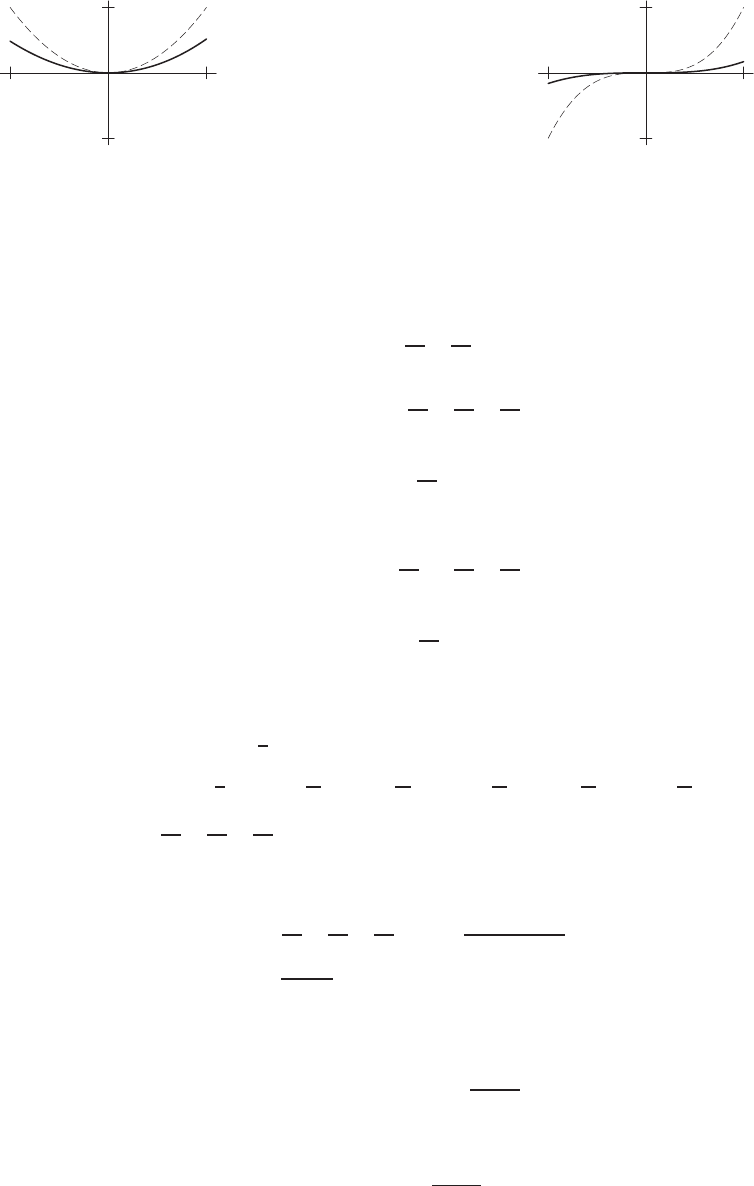
SOLUTIONS to Review Problems for Chapter Ten 1001
−0.1 0.1
−0.01
0.01
x
y
y=x2
E1
Figure 10.39
−0.1
0.1
−0.001−0.001
x
y
y=x3
E2
Figure 10.40
(b) See Figure 10.40. The graph of E2looks like a cubic, sandwiched between the graph of y=x3and the xaxis, so
|E2| ≤ x3for |x| ≤ 0.1.
(c) Using the Taylor expansion
ex= 1 + x+x2
2! +x3
3! +···
we see that
E1=ex−(1 + x) = x2
2! +x3
3! +x4
4! +···.
Thus for small x, the x2/2! term dominates, so
E1≈x2
2! ,
and so E1is approximately a quadratic.
Similarly
E2=ex−(1 + x+x2
2) = x3
3! +x4
4! +···.
Thus for small x, the x3/3! term dominates, so
E2≈x3
3!
and so E2is approximately a cubic.
42. (a) We have
P7(x) = f(0) + f′(0)x+1
2f′′(0)x2+···
= 0 + 1 ·x+1
2·0·x2+1
3! (2!)x3+1
4! ·0·x4+1
5! (4!)x5+1
6! ·0·x6+1
7! (6!)x7
=x+x3
3+x5
5+x7
7.
(b) We infer from the pattern in part (a) that:
f(x) = x+x3
3+x5
5+x7
7+···+x(odd number)
same odd number +···
=∞
X
k=0
x2k+1
2k+ 1 .
43. (a) The Taylor polynomial of degree 2 is
V(x)≈V(0) + V′(0)x+V′′(0)
2x2.
Since x= 0 is a minimum, V′(0) = 0 and V′′(0) >0. We can not say anything about the sign or value of V(0).
Thus
V(x)≈V(0) + V′′(0)
2x2.
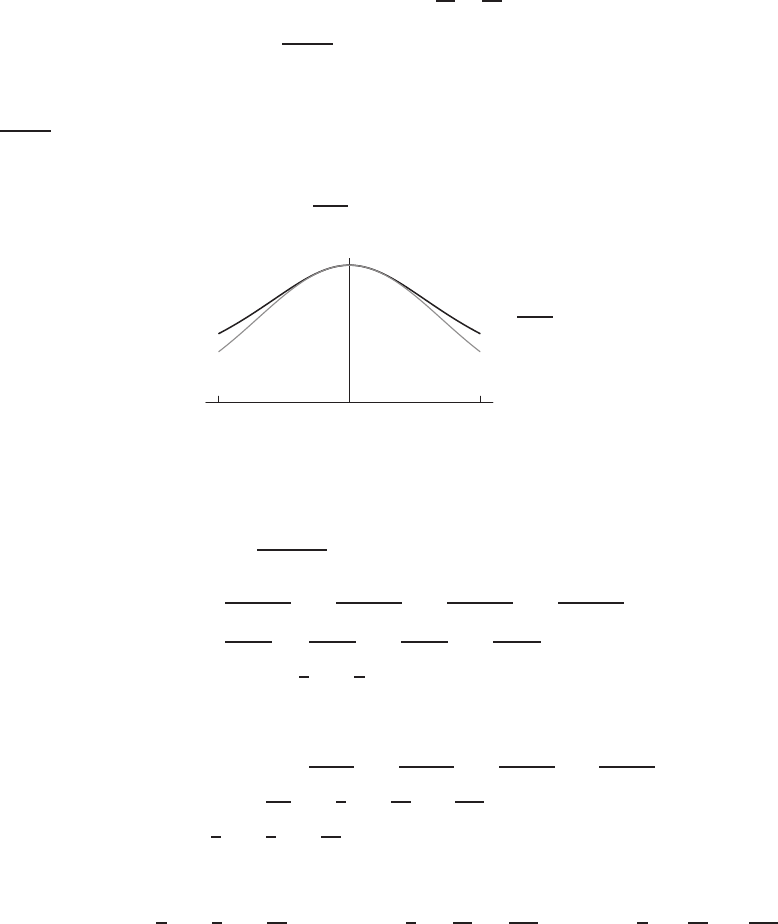
1002 Chapter Ten /SOLUTIONS
(b) Differentiating gives an approximation to V′(x)at points near the origin
V′(x)≈V′′(0)x.
Thus, the force on the particle is approximated by −V′′(0)x.
Force =−V′(x)≈ −V′′(0)x.
Since V′′(0) >0, the force is approximately proportional to xwith negative proportionality constant, −V′′(0). This
means that when xis positive, the force is negative, which means pointing toward the origin. When xis negative, the
force is positive, which means pointing toward the origin. Thus, the force always points toward the origin.
Physical principles tell us that the particle is at equilibrium at the minimum potential. The direction of the force
toward the origin supports this, as the force is tending to restore the particle to the origin.
44. (a) For reference, Figure 10.41 shows the graphs of the two functions.
e−x2= 1 −x2+x4
2! −x6
3! +···
1
1 + x2= 1 −x2+x4−x6+···
Notice that the first two terms are the same in both series.
(b) 1
1 + x2is greater.
(c) Even, because the only terms involved are of even degree.
(d) The coefficients for e−x2become extremely small for higher powers of x,and we can “counteract” the effect of these
powers for large values of x. The series for 1
1+x2has no such coefficients.
−1 1
1
y=e−x2
y=1
1+x2
x
y
Figure 10.41
45. We have:
P4(x) =
4
X
n=1
(−n)n−1
n!xn
=(−1)1−1
1! x1+(−2)2−1
2! x2+(−3)3−1
3! x3+(−4)4−1
4! x4
=(−1)0
1x+(−2)1
2x2+(−3)2
6x3+(−4)3
24 x4
=x−x2+3
2x3−8
3x4.
46. We can approximate f(x)using the Taylor polynomial of degree 5:
P5(x) = f(0) + f′(0)x+f′′(0)
2! x2+f(3)(0)
3! x3+f(4)(0)
4! x4+f(5)(0)
5! x5
= 2 + 0 ·x+−1
2x2+0
6x3−3
24 x4+6
120 x5
= 2 −1
2x2−1
8x4+1
20 x5.
Thus,
Z2
0
f(x)dx ≈Z2
02−1
2x2−1
8x4+1
20 x5dx = 2x−1
6x3−1
40 x5+1
120 x6
2
0
= 2·2−1
6·23−1
40 ·25+1
120 ·26= 2.4.

SOLUTIONS to Review Problems for Chapter Ten 1003
47. We have
f′(t) = t−1et
≈1
t1 + t+1
2·t2+1
6·t3
=1
t+ 1 + 1
2·t+1
6·t2.
Since fis an antiderivative of this function:
f(t) = Zf′(t)dt ≈Z1
t+ 1 + 1
2·t+1
6·t2dt
=ln t+t+1
2·1
2t2+1
6·1
3t3+C
= ln t+t+1
4t2+1
18 t3
| {z }
P3(t)
+C
so P3(t) = t+1
4t2+1
18 t3.
Note that the problem does not give enough information for us to find C. The actual definition of fis given in terms
of an improper integral; using this definition, it can be shown that Cequals the so-called Euler-Mascheroni constant
λ= 0.57721 ....
48. This time we are interested in how a function behaves at large values in its domain. Therefore, we don’t want to expand
V= 2πσ(√R2+a2−R)about R= 0. We want to find a variable which becomes small as Rgets large. Since R > a,
it is helpful to write
V=R2πσ r1 + a2
R2−1!.
We can now expand a series in terms of (a
R)2. This may seem strange, but suspend your disbelief. The Taylor series for
q1 + a2
R2is
1 + 1
2
a2
R2+(1/2)(−1/2)
2a2
R22
+···
So V=R2πσ 1 + 1
2
a2
R2−1
8a2
R22
+··· − 1!. For large R, we can drop the −1
8
a4
R4term and terms of higher
order, so
V≈πσa2
R.
Notice that what we really did by expanding around (a
R)2= 0 was expanding around R=∞. We then get a series that
converges for large R.
49. (a) F=GM
R2+Gm
(R+r)2
(b) F=GM
R2+Gm
R2
1
(1+ r
R)2
Since r
R<1,use the binomial expansion:
1
(1 + r
R)2=1 + r
R−2
= 1 −2r
R+ (−2)(−3) (r
R)2
2! +···
F=GM
R2+Gm
R21−2r
R+ 3 r
R2
− ·· ·.
(c) Discarding higher power terms, we get
F≈GM
R2+Gm
R2−2Gmr
R3
=G(M+m)
R2−2Gmr
R3.
Looking at the expression, we see that the term G(M+m)
R2is the field strength at a distance Rfrom a single particle
of mass M+m. The correction term, −2Gmr
R3, is negative because the field strength exerted by a particle of mass
(M+m)at a distance Rwould clearly be larger than the field strength at Pin the question.
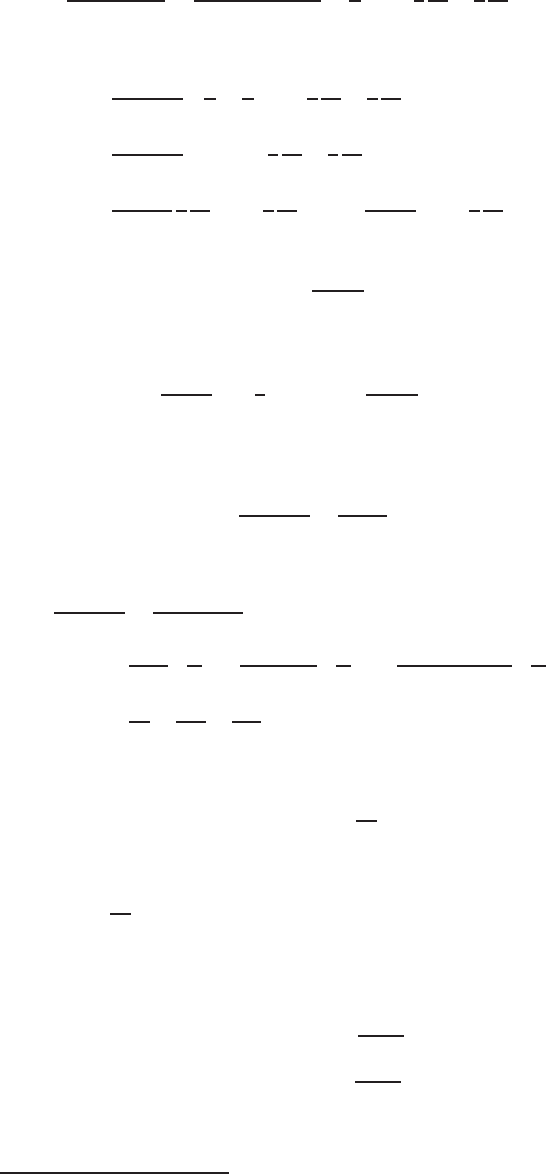
1004 Chapter Ten /SOLUTIONS
50. (a) For a/h < 1, we have
1
(a2+h2)1/2=1
h(1 + a2/h2)1/2=1
h1−1
2
a2
h2+3
8
a4
h4−....
Thus
F=2GMmh
a21
h−1
h1−1
2
a2
h2+3
8
a4
h4−...
=2GMmh
a2h1−1 + 1
2
a2
h2−3
8
a4
h4−. . .
=2GMm
a2
1
2
a2
h21−3
4
a2
h2...=GMm
h21−3
4
a2
h2−....
(b) Taking only the first nonzero term gives
F≈GMm
h2.
Notice that this approximation to Fis independent of a.
(c) If a/h = 0.02, then a2/h2= 0.0004, so
F≈GMm
h2(1 −3
4(0.0004)) = GMm
h2(1 −0.0003).
Thus, the approximations differ by 0.0003 = 0.03%.
51. (a) If his much smaller than R, we can say that (R+h)≈R, giving the approximation
F=mgR2
(R+h)2≈mgR2
R2=mg.
(b)
F=mgR2
(R+h)2=mg
(1 + h/R)2=mg(1 + h/R)−2
=mg 1 + (−2)
1! h
R+(−2)(−3)
2! h
R2
+(−2)(−3)(−4)
3! h
R3
+···
=mg1−2h
R+3h2
R2−4h3
R3+···
(c) The first order correction comes from term −2h/R. The approximation for Fis then given by
F≈mg 1−2h
R.
If the first order correction alters the estimate for Fby 10%, we have
2h
R= 0.10 so h= 0.05R≈0.05(6400) = 320 km.
The approximation F≈mg is good to within 10% — that is, up to about 300 km.
52. Since expanding f(x+h)and g(x+h)in Taylor series gives
f(x+h) = f(x) + f′(x)h+f′′(x)
2! h2+. . . ,
g(x+h) = g(x) + g′(x)h+f′′(x)
2! h2+...,
we substitute to get
f(x+h)g(x+h)−f(x)g(x)
h
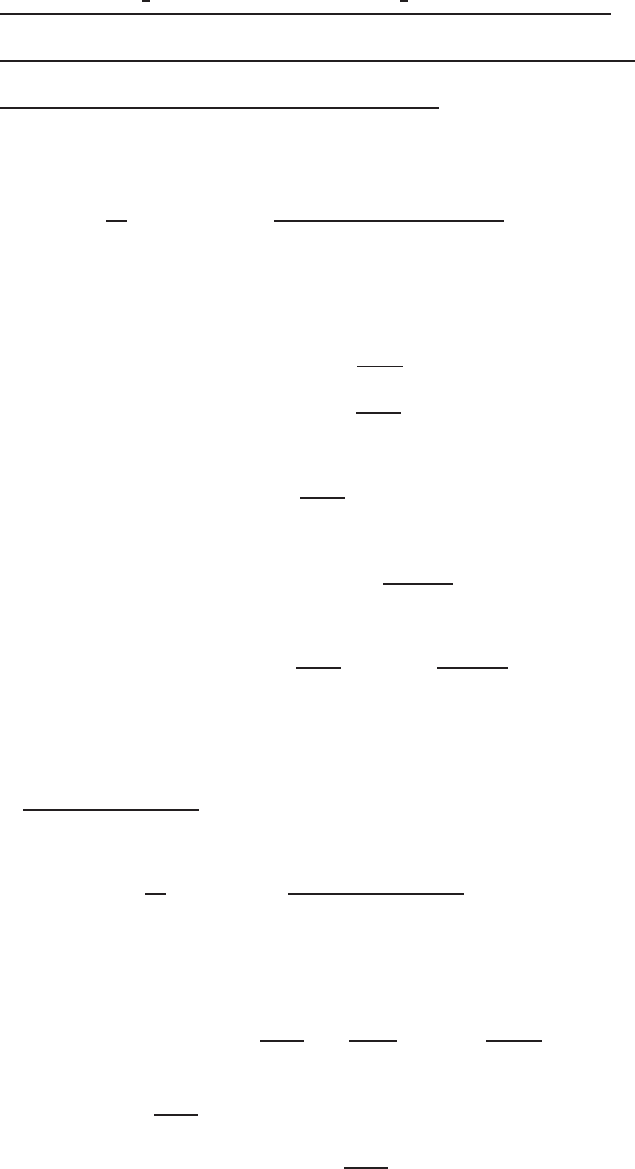
SOLUTIONS to Review Problems for Chapter Ten 1005
=(f(x) + f′(x)h+1
2f′′(x)h2+...)(g(x) + g′(x)h+1
2g′′(x)h2+...)−f(x)g(x)
h
=f(x)g(x) + (f′(x)g(x) + f(x)g′(x))h+Terms in h2and higher powers −f(x)g(x)
h
=h(f′(x)g(x) + f(x)g′(x) + Terms in hand higher powers)
h
=f′(x)g(x) + f(x)g′(x) + Terms in hand higher powers.
Thus, taking the limit as h→0, we get
d
dx (f(x)g(x)) = lim
h→0
f(x+h)g(x+h)−f(x)g(x)
h
=f′(x)g(x) + f(x)g′(x).
53. Expanding f(y+k)and g(x+h)in Taylor series gives
f(y+k) = f(y) + f′(y)k+f′′(y)
2! k2+···,
g(x+h) = g(x) + g′(x)h+g′′(x)
2! h2+···.
Now let y=g(x)and y+k=g(x+h). Then k=g(x+h)−g(x)so
k=g′(x)h+g′′(x)
2! h2+···.
Substituting g(x+h) = y+kand y=g(x)in the series for f(y+k)gives
f(g(x+h)) = f(g(x)) + f′(g(x))k+f′′(g(x))
2! k2+···.
Now, substituting for k, we get
f(g(x+h)) = f(g(x)) + f′(g(x)) ·(g′(x)h+g′′(x)
2! h2+···) + f′′(g(x))
2! (g′(x)h+...)2+···
=f(g(x)) + (f′(g(x))) ·g′(x)h+Terms in h2and higher powers.
So, substituting for f(g(x+h)) and dividing by h, we get
f(g(x+h)) −f(g(x))
h=f′(g(x)) ·g′(x) + Terms in hand higher powers,
and thus, taking the limit as h→0,
d
dx f(g(x)) = lim
h→0
f(g(x+h)) −f(g(x))
h
=f′(g(x)) ·g′(x).
54. (a) Notice g′(0) = 0 because ghas a critical point at x= 0. So, for n≥2,
g(x)≈Pn(x) = g(0) + g′′(0)
2! x2+g′′′(0)
3! x3+···+g(n)(0)
n!xn.
(b) The Second Derivative test says that if g′′(0) >0, then 0 is a local minimum and if g′′(0) <0, 0 is a local maximum.
(c) Let n= 2. Then P2(x) = g(0) + g′′(0)
2! x2.So, for xnear 0,
g(x)−g(0) ≈g′′(0)
2! x2.
If g′′(0) >0, then g(x)−g(0) ≥0, as long as xstays near 0. In other words, there exists a small interval around
x= 0 such that for any xin this interval g(x)≥g(0). So g(0) is a local minimum.
The case when g′′(0) <0is treated similarly; then g(0) is a local maximum.
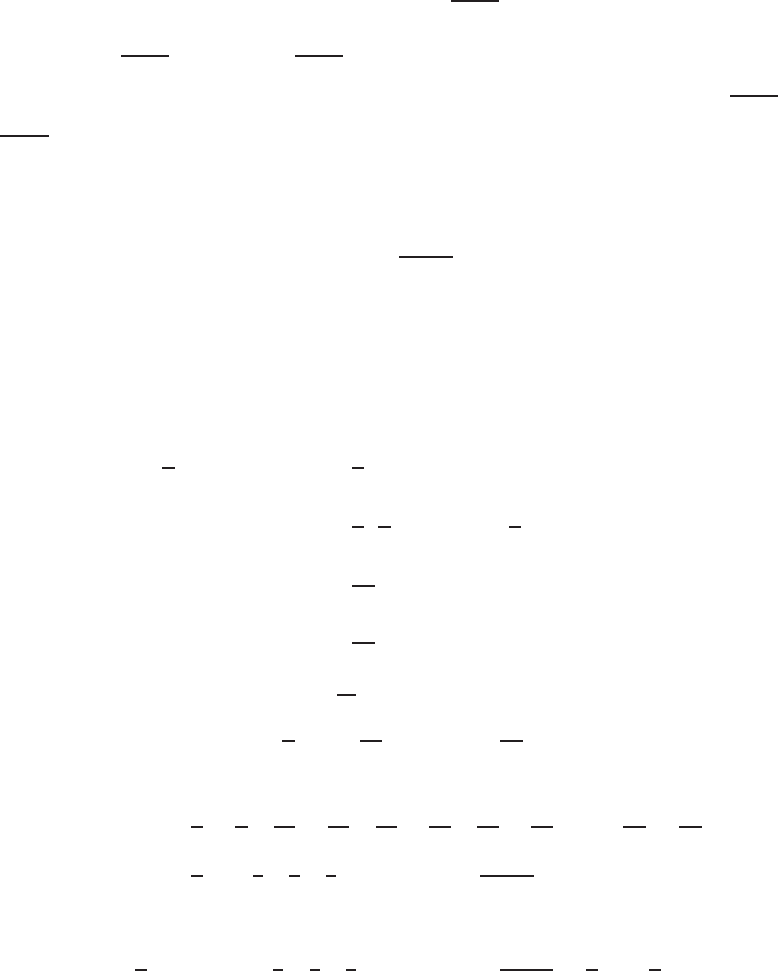
1006 Chapter Ten /SOLUTIONS
55. The situation is more complicated. Let’s first consider the case when g′′′(0) 6= 0. To be specific let g′′′(0) >0. Then
g(x)≈P3(x) = g(0) + g′′′(0)
3! x3.
So, g(x)−g(0) ≈g′′′(0)
3! x3. (Notice that g′′′(0)
3! >0is a constant.) Now, no matter how small an open interval I
around x= 0 is, there are always some x1and x2in Isuch that x1<0and x2>0, which means that g′′′(0)
3! x3
1<0
and g′′′(0)
3! x3
2>0, i.e. g(x1)−g(0) <0and g(x2)−g(0) >0. Thus, g(0) is neither a local minimum nor a local
maximum. (If g′′′(0) <0, the same conclusion still holds. Try it! The reasoning is similar.)
Now let’s consider the case when g′′′(0) = 0. If g(4)(0) >0, then by the fourth degree Taylor polynomial approxi-
mation to gat x= 0, we have
g(x)−g(0) ≈g(4)(0)
4! x4>0
for xin a small open interval around x= 0. So g(0) is a local minimum. (If g(4)(0) <0, then g(0) is a local maximum.)
In general, suppose that g(k)(0) 6= 0,k≥2, and all the derivatives of gwith order less than kare 0. In this case
glooks like cxknear x= 0, which determines its behavior there. Then g(0) is neither a local minimum nor a local
maximum if kis odd. For keven, g(0) is a local minimum if g(k)(0) >0, and g(0) is a local maximum if g(k)(0) <0.
56. Let us begin by finding the Fourier coefficients for f(x).Since fis odd, Rπ
−πf(x)dx= 0 and Rπ
−πf(x) cos nx dx = 0.
Thus ai= 0 for all i≥0. On the other hand,
bi=1
πZπ
−π
f(x) sin nx dx =1
πZ0
−π−sin(nx)dx +Zπ
0
sin(nx)dx
=1
π1
ncos(nx)
0
−π−1
ncos(nx)
π
0
=1
nπ cos 0 −cos(−nπ)−cos(nπ) + cos 0
=2
nπ 1−cos(nπ).
Since cos(nπ) = (−1)n,this is 0 if nis even, and 4
nπ if nis odd. Thus the nth Fourier polynomial (where nis odd) is
Fn(x) = 4
πsin x+4
3πsin 3x+···+4
nπ sin(nx).
Evaluating at x=π/2, we get
Fn(π/2) = 4
πsin π
2+4
3πsin 3π
2+4
5πsin 5π
2+4
7πsin 7π
2+···+4
nπ sin nπ
2
=4
π1−1
3+1
5−1
7+···+ (−1)2n+1 1
2n+ 1 .
But we are assuming Fn(π/2) approaches f(π/2) = 1 as n→ ∞,so
π
4Fn(π/2) = 1 −1
3+1
5−1
7+···+ (−1)2n+1 1
2n+ 1 →π
4·1 = π
4.
57. (a) Expand f(x)into its Fourier series:
f(x) = a0+a1cos x+a2cos 2x+a3cos 3x+··· +akcos kx +···
+b1sin x+b2sin 2x+b3sin 3x+···+bksin kx +···
Then differentiate term-by-term:
f′(x) = −a1sin x−2a2sin 2x−3a3sin 3x− ··· − kaksin kx − · ··
+b1cos x+ 2b2cos 2x+ 3b3cos 3x+···+kbkcos kx +···
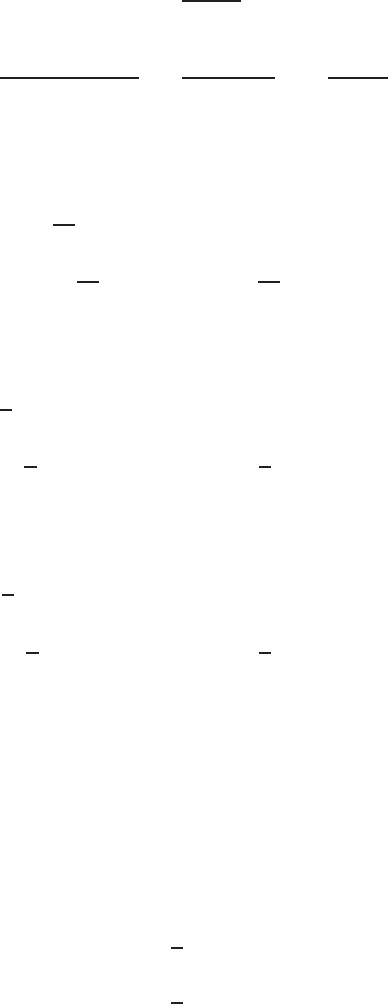
SOLUTIONS to Review Problems for Chapter Ten 1007
Regroup terms:
f′(x) = +b1cos x+ 2b2cos 2x+ 3b3cos 3x+··· +kbkcos kx +···
−a1sin x−2a2sin 2x−3a3sin 3x− ··· − kaksin kx − ···
which forms a Fourier series for the derivative f′(x). The Fourier coefficient of cos kx is kbkand the Fourier coeffi-
cient of sin kx is −kak. Note that there is no constant term as you would expect from the formula kakwith k= 0.
Note also that if the kth harmonic fis absent, so is that of f′.
(b) If the amplitude of the kth harmonic of fis
Ak=pa2
k+b2
k, k ≥1,
then the amplitude of the kth harmonic of f′is
p(kbk)2+ (−kak)2=pk2(b2
k+a2
k) = kpa2
k+b2
k=kAk.
(c) The energy of the kth harmonic of f′is k2times the energy of the kth harmonic of f.
58. Let rkand skbe the Fourier coefficients of Af +Bg. Then
r0=1
2πZπ
−πAf(x) + Bg(x)dx
=A1
2πZπ
−π
f(x)dx+B1
2πZπ
−π
g(x)dx
=Aa0+Bc0.
Similarly,
rk=1
πZπ
−πAf(x) + Bg(x)cos(kx)dx
=A1
πZπ
−π
f(x) cos(kx)dx+B1
πZπ
−π
g(x) cos(kx)dx
=Aak+Bck.
And finally,
sk=1
πZπ
−πAf(x) + Bg(x)sin(kx)dx
=A1
πZπ
−π
f(x) sin(kx)dx+B1
πZπ
−π
g(x) sin(kx)dx
=Ack+Bdk.
59. Since g(x) = f(x+c), we have that [g(x)]2= [f(x+c)]2, so g2is f2shifted horizontally by c. Since fhas period 2π,
so does f2and g2. If you think of the definite integral as an area, then because of the periodicity, integrals of f2over any
interval of length 2πhave the same value. So
Energy of f=Zπ
−π
(f(x))2dx =Zπ+c
−π+c
(f(x))2dx.
Now we know that
Energy of g=1
πZπ
−π
(g(x))2dx
=1
πZπ
−π
(f(x+c))2dx.
Using the substitution t=x+c, we see that the two energies are equal.
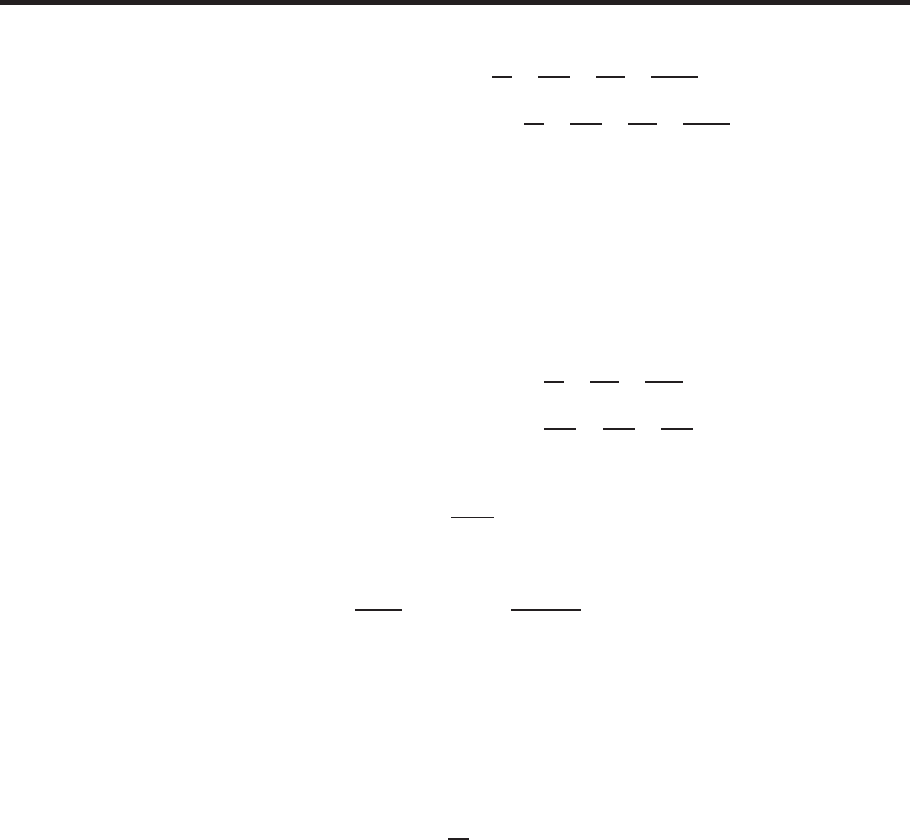
1008 Chapter Ten /SOLUTIONS
CAS Challenge Problems
60. (a) The Taylor polynomials of degree 10 are
For sin2x,P10(x) = x2−x4
3+2x6
45 −x8
315 +2x10
14175
For cos2x,Q10(x) = 1 −x2+x4
3−2x6
45 +x8
315 −2x10
14175
(b) The coefficients in P10(x)are the negatives of the corresponding coefficients of Q10(x). The constant term of P10(x)
is 0 and the constant term of Q10(x)is 1. Thus, P10(x)and Q10(x)satisfy
Q10(x) = 1 −P10(x).
This makes sense because cos2xand sin2xsatisfy the identity
cos2x= 1 −sin2x.
61. (a) The Taylor polynomials of degree 7 are
For sin x,P7(x) = x−x3
6+x5
120 −x7
5040
For sin xcos x,Q7(x) = x−2x3
3+2x5
15 −4x7
315
(b) The coefficient of x3in Q7(x)is −2/3, and the coefficient of x3in P7(x)is −1/6, so the ratio is
−2/3
−1/6= 4.
The corresponding ratios for x5and x7are
2/15
1/120 = 16 and −4/315
−1/5040 = 64.
(c) It appears that the ratio is always a power of 2. For x3, it is 4 = 22; for x5, it is 16 = 24; for x7, it is 64 = 26. This
suggests that in general, for the coefficient of xn, it is 2n−1.
(d) From the identity sin(2x) = 2 sin xcos x, we expect that P7(2x) = 2Q7(x). So, if anis the coefficient of xnin
P7(x), and if bnis the coefficient of xnin Q7(x), then, since the xnterms P7(2x)and 2Q7(x)must be equal, we
have
an(2x)n= 2bnxn.
Dividing both sides by xnand combining the powers of 2, this gives the pattern we observed. For an6= 0,
bn
an
= 2n−1.
62. (a) For f(x) = x2we have f′(x) = 2xso the tangent line is
y=f(2) + f′(2)(x−2) = 4 + 4(x−2)
y= 4x−4.
For g(x) = x3−4x2+ 8x−7, we have g′(x) = 3x2−8x+ 8, so the tangent line is
y=g(1) + g′(1)(x−1) = −2 + 3(x−1)
y= 3x−5.
For h(x) = 2x3+ 4x2−3x+ 7, we have h′(x) = 6x2+ 8x−3. So the tangent line is
y=h(−1) + h′(−1)(x+ 1) = 12 −5(x+ 1)
y=−5x+ 7.
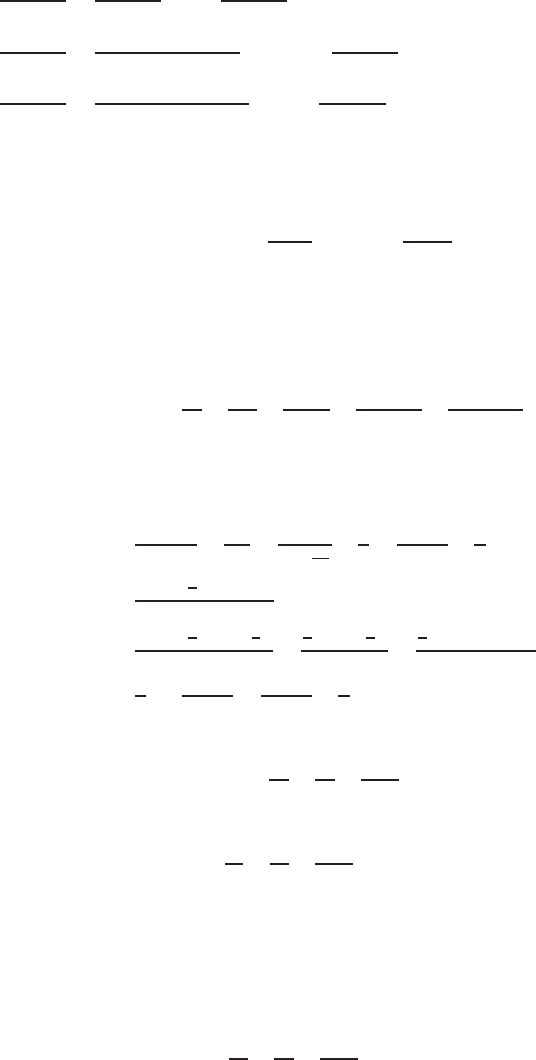
SOLUTIONS to Review Problems for Chapter Ten 1009
(b) Division by a CAS or by hand gives
f(x)
(x−2)2=x2
(x−2)2= 1 + 4x−4
(x−2)2so r(x) = 4x−4,
g(x)
(x−1)2=x3−4x2+ 8x−7
(x−1)2=x−2 + 3x−5
(x−1)2so r(x) = 3x−5,
h(x)
(x+ 1)2=2x3+ 4x2−3x+ 7
(x+ 1)2= 2x+−5x+ 7
(x+ 1)2=so r(x) = −5x+ 7.
(c) In each of these three cases, y=r(x)is the equation of the tangent line. We conjecture that this is true in general.
(d) The Taylor expansion of a function p(x)is
p(x) = p(a) + p′(a)(x−a) + p′′(a)
2! (x−a)2+p′′′(a)
3! (x−a)3+···
Now divide p(x)by (x−a)2. On the right-hand side, all terms from p′′(a)(x−a)2/2! onward contain a power of
(x−a)2and divide exactly by (x−a)2to give a polynomial q(x), say. So the remainder is r(x) = p(a)+p′(a)(x−a),
the tangent line.
63. (a) The Taylor polynomial is
P10(x) = 1 + x2
12 −x4
720 +x6
30240 −x8
1209600 +x10
47900160
(b) All the terms have even degree. A polynomial with only terms of even degree is an even function. This suggests that
fmight be an even function.
(c) To show that fis even, we must show that f(−x) = f(x).
f(−x) = −x
e−x−1+−x
2=x
1−1
ex−x
2=xex
ex−1−x
2
=xex−1
2x(ex−1)
ex−1
=xex−1
2xex+1
2x
ex−1=
1
2xex+1
2x
ex−1=
1
2x(ex−1) + x
ex−1
=1
2x+x
ex−1=x
ex−1+x
2=f(x)
64. (a) The Taylor polynomial is
P11(x) = x3
3−x7
42 +x11
1320 .
(b) Evaluating, we get
P11(1) = 13
3−17
42 +111
1320 = 0.310281
S(1) = Z1
0
sin(t2)dt = 0.310268.
We need to take about 6 decimal places in the answer as this allows us to see the error. (The values of P11(1) and
S(1) start to differ in the fifth decimal place.) Thus, the percentage error is (0.310281 −0.310268)/0.310268 =
0.000013/0.310268 = 0.000042 = 0.0042%. On the other hand,
P11(2) = 23
3−27
42 +211
1320 = 1.17056
S(2) = Z2
0
sin(t2)dt = 0.804776.
The percentage error in this case is (1.17056 −0.804776)/0.804776 = 0.365784/0.804776 = 0.454517, or about
45%.
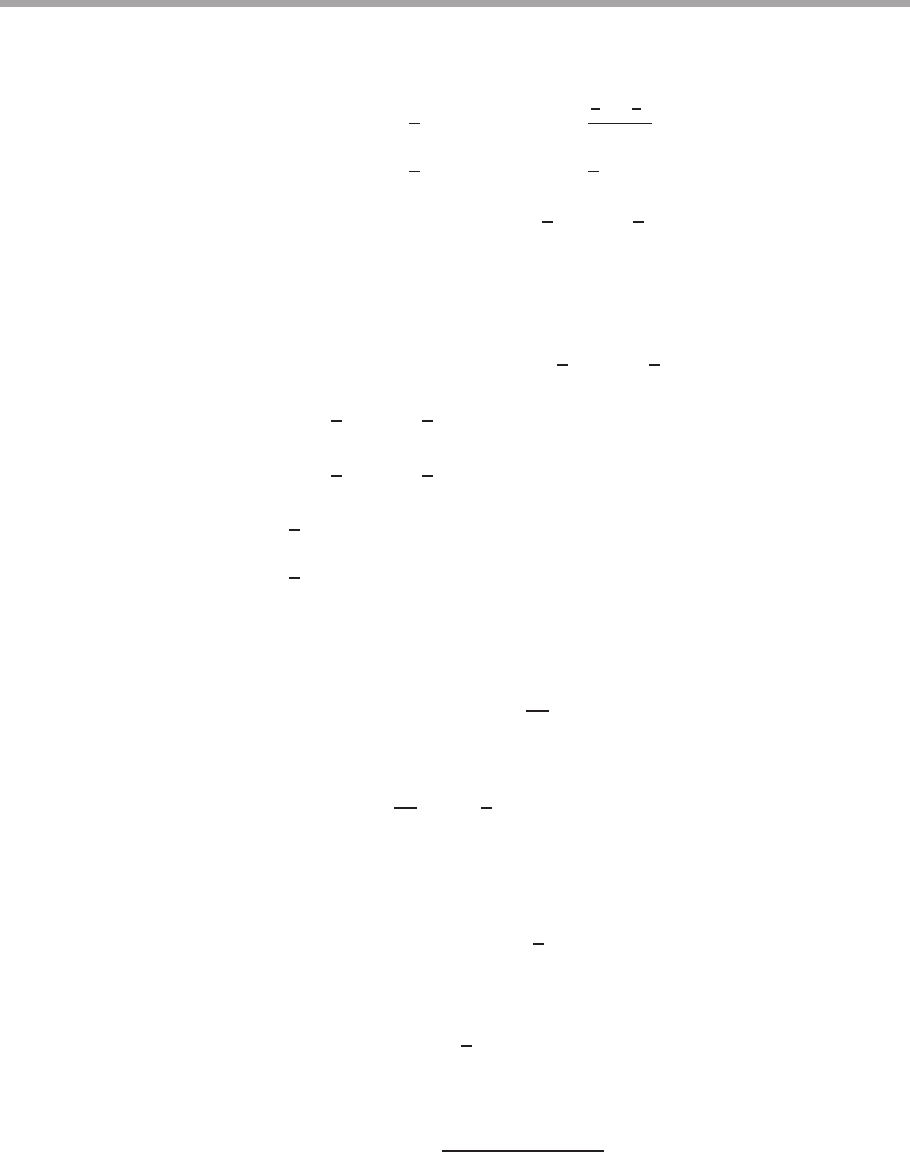
1010 Chapter Ten /SOLUTIONS
PROJECTS FOR CHAPTER TEN
1. (a) We rewrite the denominator as (1 + (A2−2A) cos2θ)−1/2and expand using a binomial series. Since we
do not want terms beyond the quadratic, we omit terms with powers higher than A2.
(1+(A2−2A) cos2θ)−1/2= 1 −1
2(A2−2A) cos2θ−
1
2−3
2
2! (A2−2A)2cos4θ+···
= 1 −1
2(A2−2A)cos2θ+3
8(A4−4A3+ 4A2) cos4θ+···
= 1 + Acos2θ+A23
2cos4θ−1
2cos2θ+···
Now multiply by (1 −Acos2θ), again omitting powers higher than A2:
cos α= (1 −Acos2θ)(1 + (A2−2A) cos2θ)−1/2
= (1 −Acos2θ)1 + Acos2θ+A23
2cos4θ−1
2cos2θ+···
= 1 + A23
2cos4θ−1
2cos2θ−cos4θ+···
= 1 + A21
2cos4θ−1
2cos2θ+···
= 1 + 1
2A2cos2θ(cos2θ−1) + ···
≈1−1
2A2cos2θsin2θ.
The approximation of part (a) is therefore the approximation of cos αby its quadratic Taylor polynomial.
(b) Since the bulge in the earth is so small, we have α≈0. Therefore to a good accuracy we can approximate
cos αby its Taylor series about 0,
cos α≈1−α2
2.
By part (a) we have
1−α2
2≈1−1
2A2cos2θsin2θ
α2≈A2cos2θsin2θ.
Using the identity sin(2θ) = 2 sin θcos θwe get
α2≈A2cos2θsin2θ=1
4A2sin2(2θ),
and therefore, since A > 0, and taking αand θto be positive, we have
α≈1
2Asin(2θ).
(c) The value of αis the exact value and (1/2)Asin(2θ)is the approximation. Thus, we have
Error =(1/2)Asin(2θ)−α
α.
Letting A= 0.0034 and expressing all angles in degrees, we have Table 10.2:
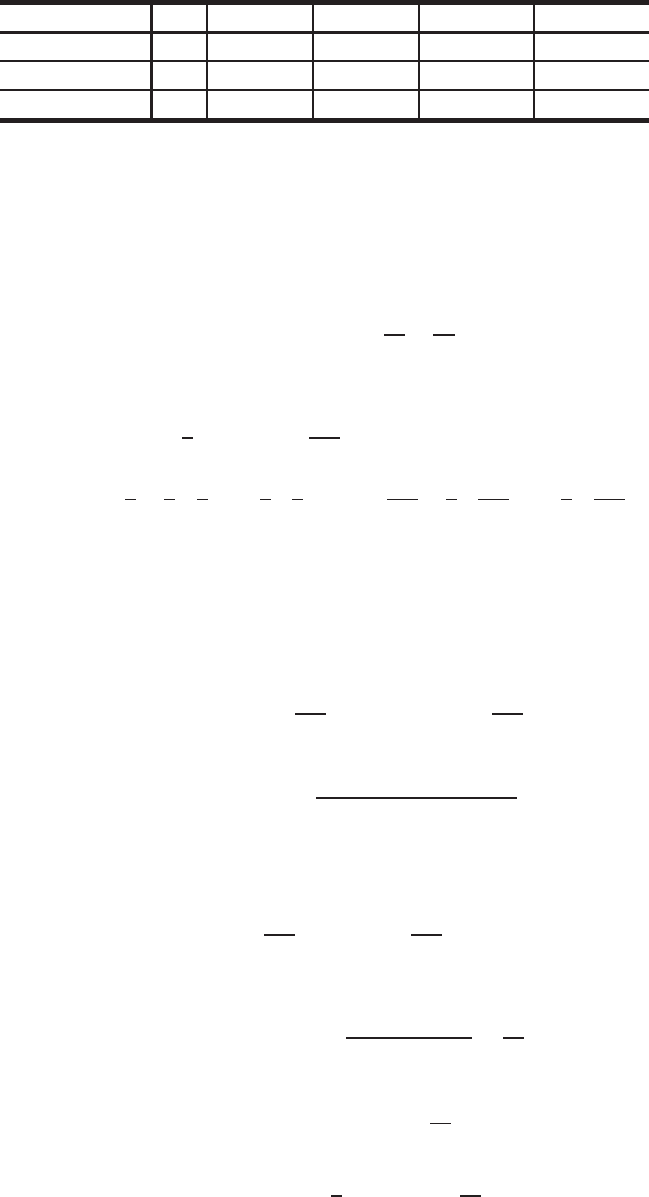
PROJECTS FOR CHAPTER TEN 1011
Table 10.2
θ0◦20◦40◦60◦80◦
α0◦0.06280◦0.09611◦0.084425◦0.033317◦
(1/2)Asin(2θ) 0◦0.06261◦0.09592◦0.084353◦0.033314◦
Error 0 0.30% 0.20% 0.085% 0.010%
2. (a) A calculator gives 4 tan−1(1/5) −tan−1(1/239) = 0.7853981634, which agrees with π/4to ten decimal
places. Notice that you cannot verify that Machin’s formula is exactly true numerically (because any cal-
culator has only a finite number of digits.) Showing that the formula is exactly true requires a theoretical
argument.
(b) The Taylor polynomial of degree 5 approximating arctan xis
arctan x≈x−x3
3+x5
5.
Thus,
π= 4 4 arctan 1
5−arctan 1
239
≈4 4 1
5−1
31
53
+1
51
55!− 1
239 −1
31
2393
+1
51
2395!!
≈3.141621029.
The true value is π= 3.141592653 ....
(c) Because the values of x, namely x= 1/5and x= 1/239, are much smaller than 1, the terms in the series
get smaller much faster.
(d) (i) If A= arctan(120/119) and B=−arctan(1/239), then
tan A=120
119 and tan B=−1
239.
Substituting
tan(A+B) = (120/119) + (−1/239)
1−(120/119)(−1/239) = 1.
Thus
A+B= arctan 1,
so
arctan 120
119−arctan 1
239= arctan 1.
(ii) If A=B= arctan(1/5), then
tan(A+B) = (1/5) + (1/5)
1−(1/5)(1/5) =5
12.
Thus
A+B= arctan 5
12,
so
2 arctan 1
5= arctan 5
12.
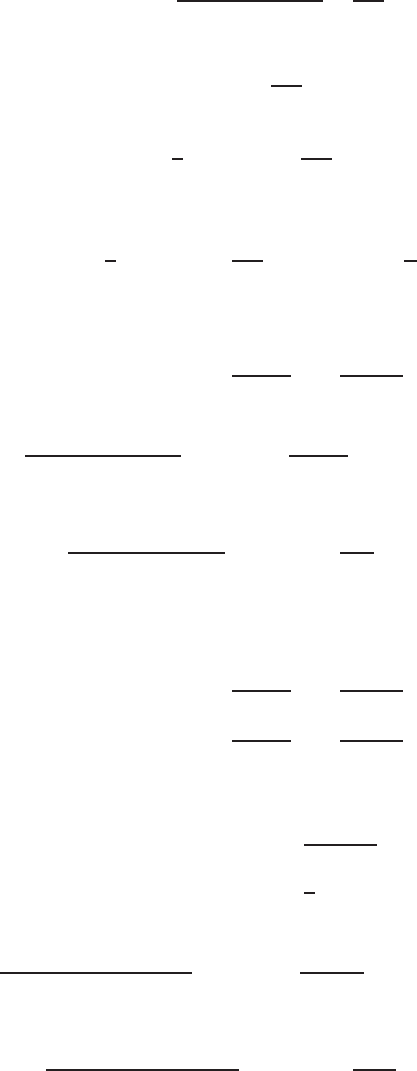
1012 Chapter Ten /SOLUTIONS
If A=B= 2 arctan(1/5), then tan A= tan B= 5/12, so
tan(A+B) = (5/12) + (5/12)
1−(5/12)(5/12) =120
119.
Thus
A+B= arctan 120
119,
so
4 arctan 1
5= arctan 120
119.
(iii) Using the result of part (a) and substituting the results of part (b), we obtain
4 arctan 1
5−arctan 1
239= arctan 1 = π
4.
3. (a) (i) Using a Taylor series expansion, we have
f(x0−h) = f(x0)−f′(x0)h+f′′(x0)
2h2−f′′′(x0)
3! h3+···.
So we have f(x0)−f(x0−h)
h−f′(x0)≈f′′(x0)
2h+···.
This suggests the following bound for small h:
f(x0)−f(x0−h)
h−f′(x0)≤Mh
2,
where |f′′(x)| ≤ Mfor |x−x0|<|h|.
(ii) We use Taylor series expansions:
f(x0+h)=f(x0) + f′(x0)h+f′′(x0)
2h2+f′′′(x0)
3! h3+···
f(x0−h) = f(x0)−f′(x0)h+f′′(x0)
2h2−f′′′(x0)
3! h3+···.
Subtracting gives
f(x0+h)−f(x0−h)= 2f′(x0)h+2f′′′(x0)
3! h3+···
= 2f′(x0)h+1
3f′′′(x0)h3+···.
So f(x0+h)−f(x0−h)
2h=f′(x0) + f′′′(x0)
6h2+···.
This suggests the following bound for small h:
f(x0+h)−f(x0−h)
2h−f′(x0)≤Mh2
6,
where |f′′′(x)| ≤ Mfor |x−x0|<|h|.
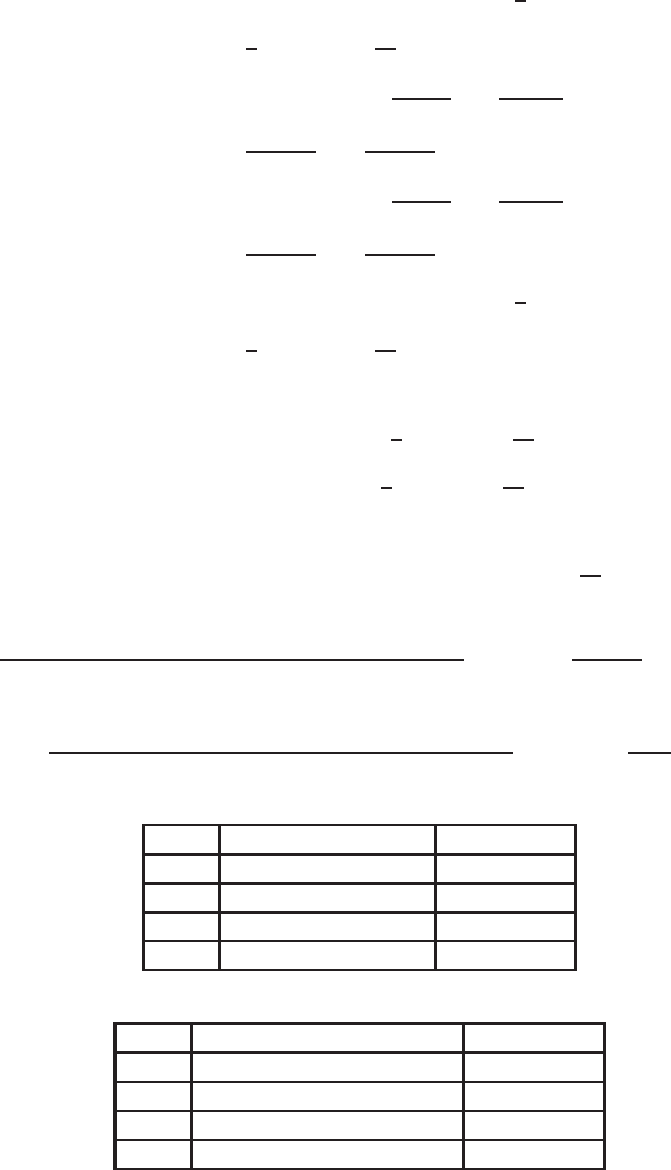
PROJECTS FOR CHAPTER TEN 1013
(iii) Expanding each term in the numerator is a Taylor series, we have
f(x0+ 2h) = f(x0) + 2f′(x0)h+ 2f′′(x0)h2+4
3f′′′(x0)h3
+2
3f(4)(x0)h4+4
15f(5)(x0)h5+···
f(x0+h) = f(x0) + f′(x0)h+f′′(x0)
2h2+f′′′(x0)
3! h3
+f(4)(x0)
4! h4+f(5)(x0)
5! h5+···,
f(x0−h) = f(x0)−f′(x0)h+f′′(x0)
2h2−f′′′(x0)
3! h3
+f(4)(x0)
4! h4−f(5)(x0)
5! h5+···,
f(x0−2h)=f(x0)−2f′(x0)h+ 2f′′(x0)h2−4
3f′′′(x0)h3
+2
3f(4)(x0)h4−4
15f(5)(x0)h5+···.
Combining the expansions in pairs, we have
8f(x0+h)−8f(x0−h)= 16f′(x0)h+8
3f′′′(x0)h3+2
15f(5)(x0)h5+···
f(x0+ 2h)−f(x0−2h) = 4f′(x0)h+8
3f′′′(x0)h3+8
15f(5)(x0)h5+···.
Thus,
−f(x0+ 2h)+ 8f(x0+h)−8f(x0−h) + f(x0−2h) = 12f′(x0)h−6
15f(5)(x0)h5+···
so
−f(x0+ 2h) + 8f(x0+h)−8f(x0−h) + f(x0−2h)
12h=f′(x0)−f(5)(x0)
30 h4+···.
This suggests the following bound for small h,
−f(x0+ 2h)+ 8f(x0+h)−8f(x0−h) + f(x0−2h)
12h−f′(x0)≤Mh4
30 ,
where |f(5)(x)| ≤ Mfor |x−x0| ≤ |h|.
(b) (i) h(f(x0)−f(x0−h))/h Error
10−10.951626 4.837 ×10−2
10−20.995017 4.983 ×10−3
10−30.9995 4.998 ×10−4
10−40.99995 5 ×10−5
The errors are roughly proportional to h, agreeing with part (a).
(ii) h(f(x0+h)−f(x0−h))/(2h)Error
10−11.00167 1.668 ×10−3
10−21.00001667 1.667 ×10−5
10−31.0000001667 1.667 ×10−7
10−41.000000001667 1.667 ×10−9
The errors are roughly proportional to h2, agreeing with part (a).
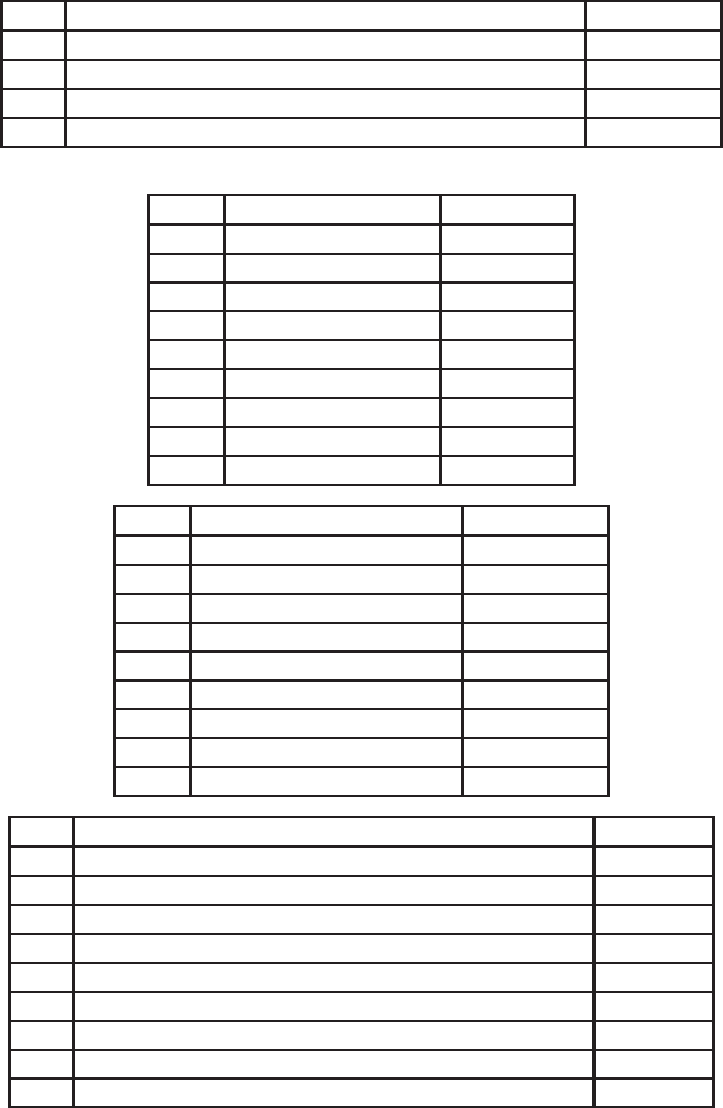
1014 Chapter Ten /SOLUTIONS
(iii) h(−f(x0+ 2h) + 8f(x0+h)−8f(x0−h) + f(x0−2h))/(12h)Error
10−10.99999667 3.337 ×10−6
10−20.9999999999667 3.333 ×10−10
10−30.99999999999999667 3.333 ×10−14
10−40.999999999999999999667 3.333 ×10−18
The errors are roughly proportional to h4, agreeing with part (a). This is the most accurate formula.
(c) (i) h(f(x0)−f(x0−h))/h Error
10−11.0001 ×1061.00 ×1010
10−21.0001 ×1071.00 ×1010
10−31.0101 ×1081.01 ×1010
10−41.11111 ×1091.11 ×1010
10−5Undefined Undefined
10−6−1.11111 ×1010 −1.11 ×109
10−7−1.0101 ×1010 −1.01 ×108
10−8−1.001 ×1010 −1.00 ×107
10−9−1.0001 ×1010 −1.00 ×106
(ii) h(f(x0+h)−f(x0−h))/(2h)Error
10−11×1021×1010
10−21×1041×1010
10−31.0001 ×1061.0001 ×1010
10−41.0101 ×1081.0101 ×1010
10−5Undefined Undefined
10−6−1.0101 ×1010 −1.01 ×108
10−7−1.0001 ×1010 −1.00 ×106
10−8−1.000001 ×1010 −1.00 ×104
10−9−1.00000001 ×1010 −1.00 ×102
(iii) h(−f(x0+ 2h) + 8f(x0+h)−8f(x0−h) + f(x0−2h))/(12h)Error
10−11.25 ×1021.00 ×1010
10−21.25 ×1041.00 ×1010
10−31.25013 ×1061.00 ×1010
10−41.26326 ×1081.01 ×1010
10−5Undefined Undefined
10−6−9.99579 ×1094.21 ×106
10−7−9.9999995998 ×1010 4.00 ×102
10−8−9.99999999996 ×1010 4.00 ×10−2
10−9−9.999999999999996 ×1010 4.00 ×10−6
For relatively large values of h, these approximation formulas fail miserably. The main reason is that
f(x) = 1/x changes very quickly at x0= 10−5. In fact, f(x)→±∞ as x→0. So we must use very
small values for hwhen estimating a limit (involving fand x0= 10−5) as h→0. Here, h > 10−5is too
big, since the values of x0−hcross over the discontinuity at x= 0. For smaller values of h, that make
sure we stay on the good side of the abyss, these formulas work quite well. Already by h= 10−6, formula
(c) is the best approximation.
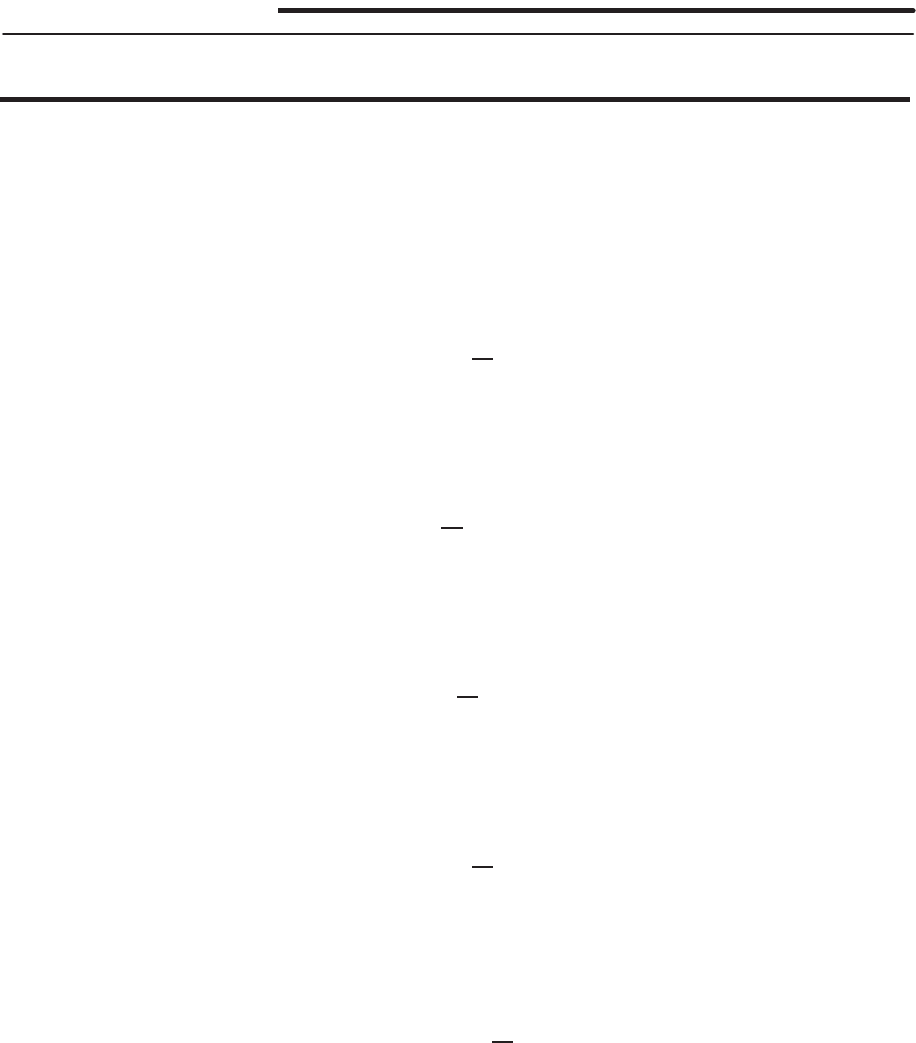
11.1 SOLUTIONS 1015
CHAPTER ELEVEN
Solutions for Section 11.1
Exercises
1. Since y=x3, we know that y′= 3x2. Substituting y=x3and y′= 3x2into the differential equation we get
0 = xy′−3y
=x(3x2)−3(x3)
= 3x3−3x3
= 0.
Since this equation is true for all x, we see that y=x3is in fact a solution.
2. (a) We substitute y=x4and its derivative dy/dx = 4x3into the differential equation:
xdy
dx = 4y
x(4x3) = 4(x4)?
Yes: 4x4= 4x4.
The function y=x4satisfies the differential equation so it is a solution.
(b) We substitute y=x4+ 3 and its derivative dy/dx = 4x3into the differential equation:
xdy
dx = 4y
x(4x3) = 4(x4+ 3)?
4x46= 4x4+ 12.
The function y=x4+ 3 does not satisfy the differential equation so it is not a solution.
(c) We substitute y=x3and its derivative dy/dx = 3x2into the differential equation:
xdy
dx = 4y
x(3x2) = 4(x3)?
3x36= 4x3.
The function y=x3does not satisfy the differential equation so it is not a solution.
(d) We substitute y= 7x4and its derivative dy/dx = 28x3into the differential equation:
xdy
dx = 4y
x(28x3) = 4(7x4)?
Yes: 28x4= 28x4.
The function y= 7x4satisfies the differential equation so it is a solution.
3. (a) We substitute y= 4x3and its derivative dy/dx = 12x2into the differential equation:
ydy
dx = 6x2
(4x3)·(12x2) = 6x2?
48x56= 6x2.
The function y= 4x3does not satisfy the differential equation so it is not a solution.
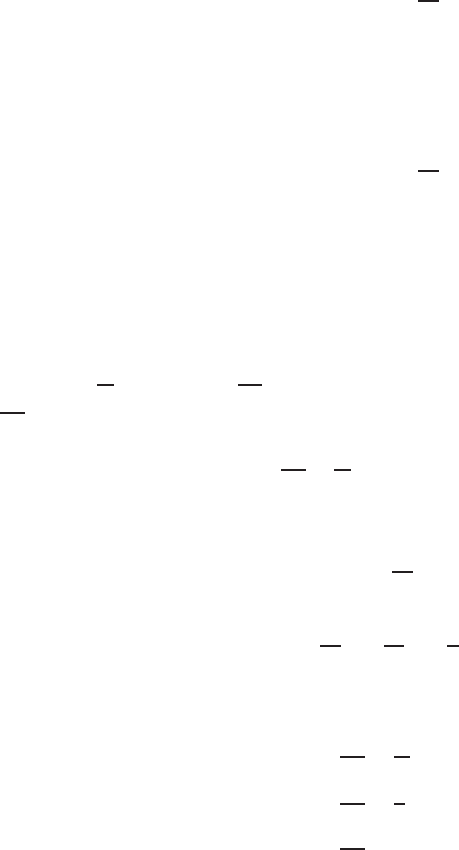
1016 Chapter Eleven /SOLUTIONS
(b) We substitute y= 2x3/2and its derivative dy/dx = 3x1/2into the differential equation:
ydy
dx = 6x2
(2x3/2)·(3x1/2) = 6x2?
Yes: 6x2= 6x2.
The function y= 2x3/2satisfies the differential equation so it is a solution.
(c) We substitute y= 6x3/2and its derivative dy/dx = 9x1/2into the differential equation:
ydy
dx = 6x2
(6x3/2)·(9x1/2) = 6x2?
54x26= 6x2.
The function y= 6x3/2does not satisfy the differential equation so it is not a solution.
4. Differentiating y(x) = Aeλx gives
y′(x) = Aλeλx =λ(Aeλx) = λy.
Therefore, y(x)is a solution of y′=λy for any value of A.
5. If y= sin 2t, then dy
dt = 2 cos 2t, and d2y
dt2=−4 sin 2t.
Thus d2y
dt2+ 4y=−4sin 2t+ 4 sin 2t= 0.
6. If P=P0et,then
dP
dt =d
dt (P0et) = P0et=P.
7. Differentiating x2+y2=r2implicitly, with ra constant, gives
2x+ 2ydy
dx = 0.
Solving for dy/dx, we get
dy
dx =−2x
2y=−x
y.
8. (a) To determine whether Qis increasing or decreasing, we check to see whether dQ/dt is positive or negative. Substi-
tuting Q= 8 and t= 2 into the differential equation, we have:
dQ
dt =t
Q−0.5
dQ
dt =2
8−0.5
dQ
dt =−0.25 <0.
Since dQ/dt is negative, we see that Qis decreasing at t= 2.
(b) Since dQ/dt =−0.25, the rate of change of Qat t= 2 is −0.25 per unit of t. If the rate of change stays ap-
proximately constant over the interval, then Qchanges by approximately −0.25 in going from t= 2 to t= 3. We
have:
Value of Qat 3≈Value of Qat 2 + Change in Q
= 8 + (−0.25)
= 7.75.
9. We know that at time t= 0 the value of yis 8. Since we are told that dy/dt = 0.5y, we know that at time t= 0 the
derivative of yis .5(8) = 4. Thus, as tgoes from 0 to 1, ywill increase by 4, so at t= 1,y= 8 + 4 = 12.
Likewise, at t= 1, we get dy/dt = 0.5(12) = 6 so that at t= 2, we obtain y= 12 + 6 = 18.
At t= 2, we have dy/dt = 0.5(18) = 9 so that at t= 3, we obtain y= 18 + 9 = 27.
At t= 3, we have dy/dt = 0.5(27) = 13.5so that at t= 4, we obtain y= 27 + 13.5 = 40.5.
Thus, we get the values in the following table
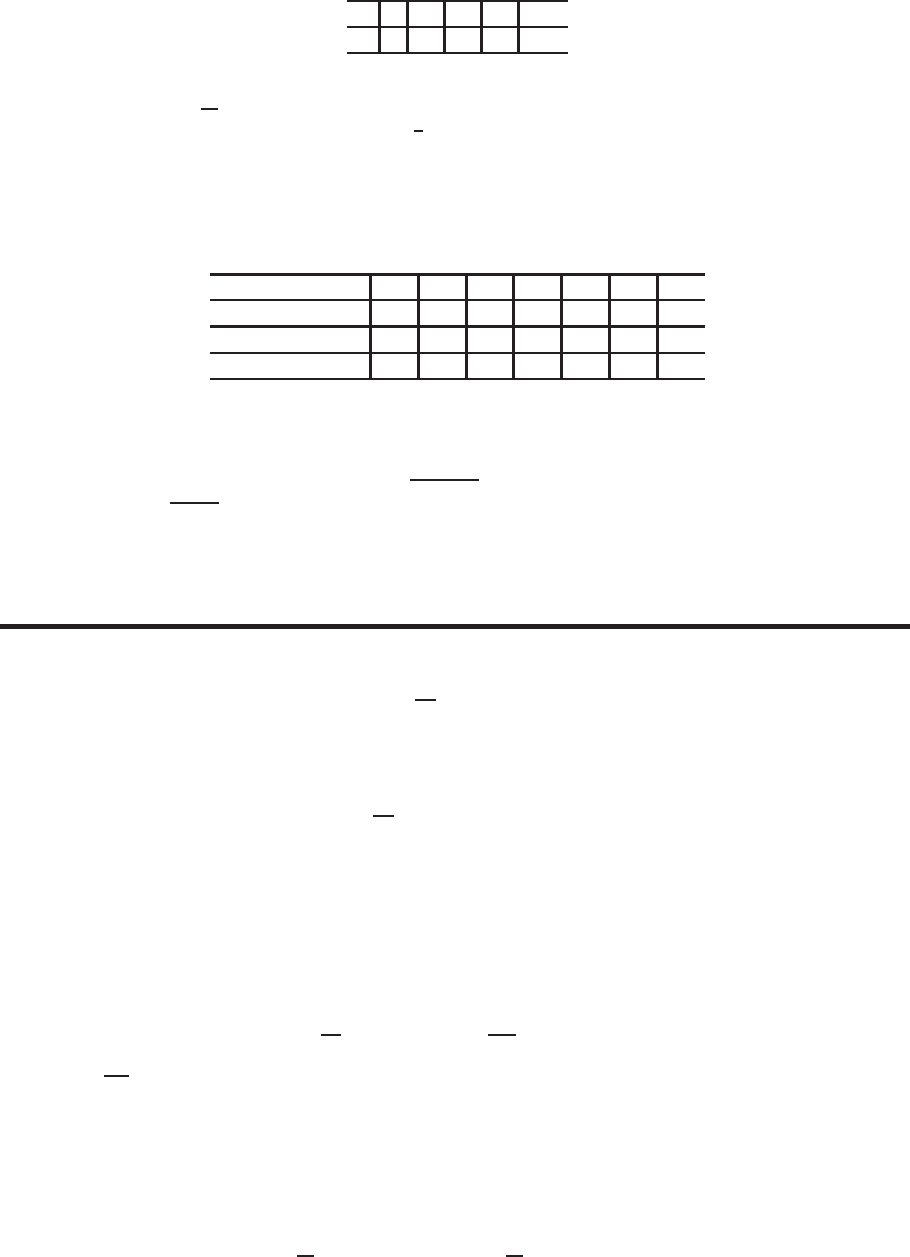
11.1 SOLUTIONS 1017
t0 1 2 3 4
y8 12 18 27 40.5
10. At the end of 5 days, dy
dt = 100 −67.2 = 32.8% per week. Thus during the next working day, which is the first day of
the second week, the amount learned is about 32.8( 1
5) = 6.6%.
At the end of 6 working days,
y≈67.2% + 6.6% = 73.8%.
Continuing in this manner gives the data in Table 11.1.
Table 11.1
Time (days) 6 7 8 9 10 11 12
learned (approximate) 73.8 79.0 83.2 86.6 89.3 91.4 93.1
Time (days) 13 14 15 16 17 18 19
learned (approximate) 94.5 95.6 96.5 97.2 97.7 98.2 98.6
11. Since x(0) = 5, we have Ce3·0= 5; that is, C= 5. So the particular solution is x(t) = 5e3t.
12. Since P= 5 when t= 3, we have 5 = C/3; therefore, C= 15. So the particular solution is P= 15/t.
13. Because y= 3 when t= 1, we know that 3 = √2·1 + C. Therefore, 2 + C= 9, and thus C= 7. So the particular
solution is y=√2t+ 7.
14. Because Q= 4 when t= 2, we have 4 = 1/(2C+C); therefore, 3C= 1/4. So C= 1/12. Thus, the particular solution
is Q= 12/(t+ 1).
Problems
15. In order to prove that y=A+Cekt is a solution to the differential equation
dy
dt =k(y−A),
we must show that the derivative of ywith respect to tis in fact equal to k(y−A):
y=A+Cekt
dy
dt = 0 + (Cekt)(k)
=kCekt
=k(Cekt +A−A)
=k(Cekt +A)−A
=k(y−A).
16. If y= cos ωt, then
dy
dt =−ωsin ωt, d2y
dt2=−ω2cos ωt.
Thus, if d2y
dt2+ 9y= 0,then
−ω2cos ωt + 9 cos ωt = 0
(9 −ω2) cos ωt = 0.
Thus 9−ω2= 0,or ω2= 9,so ω=±3.
17. Differentiating and using the fact that
d
dt (cosh t) = sinh tand d
dt (sinh t) = cosh t,
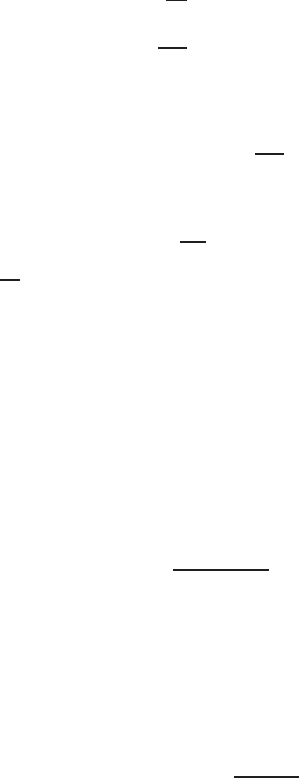
1018 Chapter Eleven /SOLUTIONS
we see that
dx
dt =ωC1sinh ωt +ωC2cosh ωt
d2x
dt2=ω2C1cosh ωt +ω2C2sinh ωt
=ω2(C1cosh ωt +C2sinh ωt).
Therefore, we see that
d2x
dt2=ω2x.
18. If Q=Cekt,then
dQ
dt =Ckekt =k(Cekt) = kQ.
We are given that dQ
dt =−0.03Q, so we know that kQ =−0.03Q. Thus we either have Q= 0 (in which case C= 0
and kis anything) or k=−0.03.Notice that if k=−0.03,then Ccan be any number.
19. Since y=x2+k, we know that y′= 2x. Substituting y=x2+kand y′= 2xinto the differential equation, we get
10 = 2y−xy′
= 2(x2+k)−x(2x)
= 2x2+ 2k−2x2
= 2k.
Thus, k= 5 is the only solution.
20. If ysatisfies the differential equation, then we must have
d(5 + 3ekx)
dx = 10 −2(5 + 3ekx)
3kekx = 10 −10 −6ekx
3kekx =−6ekx
k=−2.
So, if k=−2the formula for ysolves the differential equation.
21. (a) If y=Cxnis a solution to the given differential equation, then we must have
xd(Cxn)
dx −3(Cxn) = 0
x(Cnxn−1)−3(Cxn) = 0
Cnxn−3Cxn= 0
C(n−3)xn= 0.
Thus, if C= 0, we get y= 0 is a solution, for every n. If C6= 0, then n= 3, and so y=Cx3is a solution.
(b) Because y= 40 for x= 2, we cannot have C= 0. Thus, by part (a), we get n= 3. The solution to the differential
equation is
y=Cx3.
To determine Cif y= 40 when x= 2, we substitute these values into the equation.
40 = C·23
40 = C·8
C= 5.
So, now both Cand nare fixed at specific values.

11.1 SOLUTIONS 1019
22. (a) Differentiating y(x) = A+Bex2/2gives y′(x) = Bxex2/2so that
y′−xy −x=Bxex2/2−xA+Bex2/2−x=−x(A+ 1).
For y(x) = A+Bex2/2to be a solution we need −x(A+ 1) = 0 so A=−1.
(b) Given the solution y(x) = −1 + Bex2/2,we have y(0) = −1 + B. Since y(0) = 1,we have B= 2.
23. (a) If
y=ex+e−x
2,
then
dy
dx =ex−e−x
2,
and
d2y
dx2=ex+e−x
2.
If k= 1,then
kr1 + dy
dx 2
=r1 + ex−e−x
22
=r1 + e2x
4−1
2+e−2x
4
=re2x
4+1
2+e−2x
4=rex+e−x
22
=
ex+e−x
2=ex+e−x
2(since ex+e−x>0)
=d2y
dx2.
(b) y=eAx+e−Ax
2A, so
dy
dx =eAx −e−Ax
2and d2y
dx2=AeAx +e−Ax
2.
Therefore we have
1 + dy
dx 2
=1 + eAx −e−Ax
22
=1 + 1
4e2Ax +e−2Ax −2
=1
4e2Ax +e−2Ax + 2=1
4eAx +e−Ax2.
This means
kr1 + dy
dx 2
=kr1
4(eAx +e−Ax)2=k
2·eAx +e−Ax
=keAx +e−Ax
2(since eAx +e−Ax >0).
Since we want d2y
dx2=kq1 + dy
dx 2, we must have A=k.
24. (I) y=ex,y′=ex,y′′ =ex
(II) y=x3,y′= 3x2,y′′ = 6x
(III) y=e−x,y′=−e−x,y′′ =e−x
(IV) y=x−2,y′=−2x−3,y′′ = 6x−4
and so:
(a) (I),(III) because y′′ =yin each case.
(b) (IV) because x2y′′ + 2xy′−2y=x2(6x−4) + 2x(−2x−3)−2x−2= 6x−2−4x−2−2x−2= 0.
(c) (II),(IV) because x2y′′ = 6yin each case.

1020 Chapter Eleven /SOLUTIONS
25. (I) y= 2 sin x,dy/dx = 2 cos x,d2y/dx2=−2 sin x
(II) y= sin 2x,dy/dx = 2 cos 2x,d2y/dx2=−4 sin 2x
(III) y=e2x,dy/dx = 2e2x,d2y/dx2= 4e2x
(IV) y=e−2x,dy/dx =−2e−2x,d2y/dx2= 4e−2x
and so:
(a) (IV)
(b) (III)
(c) (III), (IV)
(d) (II)
26. (a) (IV) because dy/dx =k=kx/x =y/x.
(b) (III) because dy/dx =kekx =ky.
(c) (I) because dy/dx =kxekx +ekx =ky +xekx/x =ky +y/x.
(d) (II) because dy/dx =kxk−1=kxk/x =ky/x.
27. No, it is not the general solution since it does not contain an arbitrary constant. It is a particular solution since y′=
3e3x= 3y, but it is not the general solution.
28. (a) We substitute y=A+Be−2tand its derivative dy/dt =−2Be−2tinto the differential equation:
dy
dt = 100 −2y
−2Be−2t= 100 −2(A+Be−2t)
−2Be−2t= 100 −2A−2Be−2t
0 = 100 −2A
A= 50.
If A= 50, the function satisfies the differential equation. There are no conditions on B. The function y= 50+Be−2t
is the general solution to the differential equation.
(b) We substitute y= 85 and t= 0 into the general solution:
y= 50 + Be−2t
85 = 50 + Be−2(0)
85 = 50 + B
B= 35.
We see that B= 35. The particular solution satisfying the differential equation and the initial condition is y=
50 + 35e−2t.
Strengthen Your Understanding
29. Although Q= 6e4tsatisfies the differential equation dQ/dt = 4Q, it is not the general solution. The general solution is
the family of all possible solutions to the differential equation and contains an arbitrary constant. Q= 6e4tis only one
particular solution, not a general solution.
30. The differential equation dx/dt = 1/x represents a function x(t)whose rate of change with respect to tis 1/x. Since
x > 0when t= 0,1/x is also positive, and thus, xis increasing when tis near 0.
31. An example is dy/dx =x/y with the condition that y= 100 when x= 0. Many other examples are possible.
32. A second-order differential equation is one involving the second derivative, so an example is d2y/dx2= 3yor y′′ =xy2
or y′′ + 2y′+ 4 = 0. Many other examples are possible.
33. An example is dy/dx = 2xwith solutions y=x2and y=x2+ 5. Other examples are possible.
34. An example is dy/dx = sin x. We find the solution by integrating and see that the solution is the function y=−cos x+
C. One solution is the trigonometric function y=−cos x. Other examples are possible.
35. An example is dy/dx = 1/x. We find the solution by integrating and see that the solution is the function y= ln |x|+C.
One solution is the logarithmic function y= ln |x|. Other examples are possible.
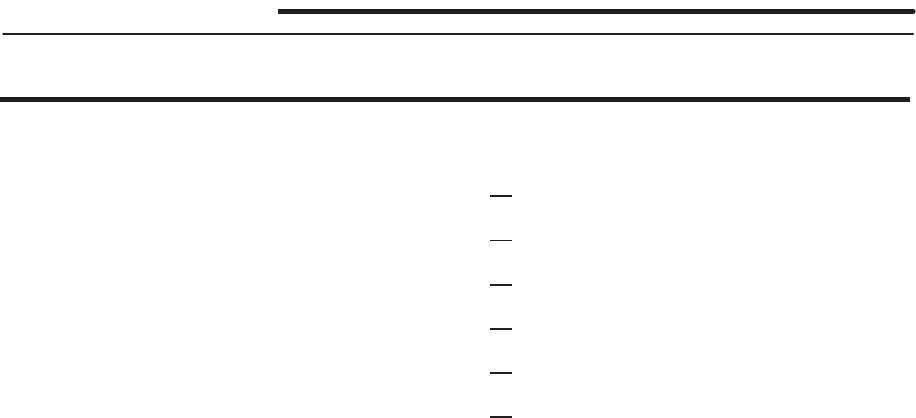
11.2 SOLUTIONS 1021
36. An example is dy/dx =ex. In fact, if f(x)is any increasing positive function, then the solutions of dy/dx =f(x)are
increasing since f(x)>0and concave up since d2y/dx2=f′(x)>0.
37. We want to have dy/dx = 0 when y−x2= 0, so let dy/dx =y−x2.
38. False. The general solution contains an arbitrary constant, but the constant may not be added to the particular solution.
For example, the differential equation dy/dt =yhas y=etas a particular solution, but the general solution is
y=Cet, which cannot be rewritten in the form y=et+C.
39. False. The function y=t2is a solution to y′′ = 2.
40. True. Since f′(x) = g(x), we have f′′(x) = g′(x). Since g(x)is increasing, g′(x)>0for all x, so f′′(x)>0for all x.
Thus the graph of fis concave up for all x.
41. False. We just need an example of a function f(x)which is decreasing for x > 0, but whose derivative f′(x) = g(x)is
increasing for x > 0. An example is f(x) = 1/x. Clearly f(x)is decreasing for x > 0but its derivative f′(x) = −1/x2
is clearly increasing for x > 0.
42. True. Since g(x)is increasing, g(x)≥g(0) = 1 for all x≥0. Since f′(x) = g(x), this means that f′(x)>0for all
x≥0. Therefore f(x)is increasing for all x≥0.
43. False. If g(x)>0for all x, then f(x)would have to be increasing for all xso f(x+p) = f(x)would be impossible.
For example, let g(x) = 2 + cos x. Then a possibility for fis f(x) = 2x+ sin x. Then g(x)is periodic, but f(x)is not.
44. False. Let g(x) = 0 for all xand let f(x) = 17. Then f′(x) = g(x)and limx→∞ g(x) = 0, but limx→∞ f(x) = 17.
45. True. Since limx→∞ g(x) = ∞, there must be some value x=asuch that g(x)>1for all x > a. Then f′(x)>1for
all x > a. Thus, for some constant C, we have f(x)> x +Cfor all x > a, which implies that limx→∞ f(x) = ∞.
More precisely, let C=f(a)−aand let h(x) = f(x)−x−C. Then h(a) = 0 and h′(x) = f′(x)−1>0for all
x > a. Thus his increasing so h(x)>0for all x > a, which means that f(x)> x +Cfor all x > a.
46. False. Let f(x) = x3and g(x) = 3x2. Then y=f(x)satisfies dy/dx =g(x)and g(x)is even while f(x)is odd.
47. False. The example f(x) = x3and g(x) = 3x2shows that you might expect f(x)to be odd. However, the additive
constant Ccan mess things up. For example, still let g(x) = 3x2, but let f(x) = x3+ 1 instead. Then g(x)is still even,
but f(x)is not odd (for example, f(−1) = 0 but −f(1) = −2).
Solutions for Section 11.2
Exercises
1. (a) The slope at any point is given by the derivative, so we find the slope by substituting the x- and y-coordinates into
the differential equation dy/dx =x2−y2to find dy/dx.
The slope at (1,0) is dy
dx = 12−02= 1.
The slope at (0,1) is dy
dx = 02−12=−1.
The slope at (1,1) is dy
dx = 12−12= 0.
The slope at (2,1) is dy
dx = 22−12= 3.
The slope at (1,2) is dy
dx = 12−22=−3.
The slope at (2,2) is dy
dx = 22−22= 0.

1022 Chapter Eleven /SOLUTIONS
(b) See Figure 11.1.
1 2
1
2
x
y
Figure 11.1
2. We substitute x- and y-coordinates into the differential equation to determine the slopes. At the point (1,1), we have
dy/dx = 1/1 = 1 so the slope is 1. At the point (1,0), we have dy/dx = 1/0, which is undefined. An undefined slope
corresponds to a vertical line segment. Continuing in this way, we create Figure 11.2.
−1 1
−1
1
x
y
Figure 11.2
3. We substitute x- and y-coordinates into the differential equation to determine the slopes. At the point (−1,2), we have
dy/dx = 22= 4 so the slope is 4. At the point (0,2), we have dy/dx = 22= 4, so the slope is again 4. Continuing in
this way, we create Figure 11.3.
−1 1
1
2
x
y
Figure 11.3
4. Figure (I) shows a line segment at (4,0) with positive slope. The only possible differential equation is (b), since at (4,0)
we have y′= cos 0 = 1.Note that (a) is not possible as y′(4,0) = e−16 = 0.0000001, a much smaller positive slope
than that shown.

11.2 SOLUTIONS 1023
Figure (II) shows a line segment at (0,4) with zero slope. The possible differential equations are (d), since at (0,4)
we have y′= 4(4 −4) = 0, and (f), since at (0,4) we have y′= 0(3 −0) = 0.
Figure (III) shows a line segment at (4,0) with negative slope of large magnitude. The only possible differential
equation is (f), since at (4,0) we have y′= 4(3−4) = −4.Note that (c) is not possible as y′(4,0) = cos(4−0) = −0.65,
a negative slope of smaller magnitude than that shown.
Figure (IV) shows a line segment at (4,0) with a negative slope of small magnitude. The only possible differential
equation is (c), since at (4,0) we have y′= cos(4−0) = −0.65.Note that (f) is not possible as y′(4,0) = 4(3−4) = −4,
a negative slope of larger magnitude than that shown.
Figure (V) shows a line segment at (0,4) with positive slope. Possible differential equations are (a), since at (0,4)
we have y′=e02= 1,and (c), since at (0,4) we have y′= cos(4 −4) = 1.
Figure (VI) shows a line segment at (0,4) with a negative slope of large magnitude. The only possible differential
equation is (e), since at (0,4) we have y′= 4(3 −4) = −4.Note that (b) is not possible as y′(0,4) = cos 4 = −0.65, a
negative slope of smaller magnitude than that shown.
5. There are many possible answers. One possibility is shown in Figures 11.4 and 11.5.
y
x
Figure 11.4
y
x
Figure 11.5
6. See Figure 11.6. Other choices of solution curves are, of course, possible.
y
x
y
x
Figure 11.6

1024 Chapter Eleven /SOLUTIONS
7. The first graph has the equation y′=x2−y2. We can see this by looking along the line y=x. On the first slope field,
it seems that y′= 0 along this line, as it should if y′=x2−y2. This is not the case for the second graph. Another way
to see this is to look along the y-axis on both graphs. The slope lines change with yon the first graph, but are constant on
the second. But at x= 0, the slope should be −y2, which varies with y, so the first graph is the one that fits.
At (0,1),y′=−1, and at (1,0),y′= 1, so we are looking for points on the axes where the line segment is sloped
at 45◦. See Figure 11.7.
(1,0)
(0,1)
y
x
x= 1
Figure 11.7
8. (a) See Figure 11.8.
−1
0
1
y
x
Figure 11.8
(b) The solution is y(x) = 1.
(c) Since y′= 0 and x(y−1) = 0, this is a solution.
9. (a) See Figure 11.9.
−4 4
−4
4
x
y
i
iiiii
Figure 11.9
(b) The solution through (−1,0) appears to be linear, so its equation is y=−x−1.
(c) If y=−x−1, then y′=−1and x+y=x+ (−x−1) = −1, so this checks as a solution.
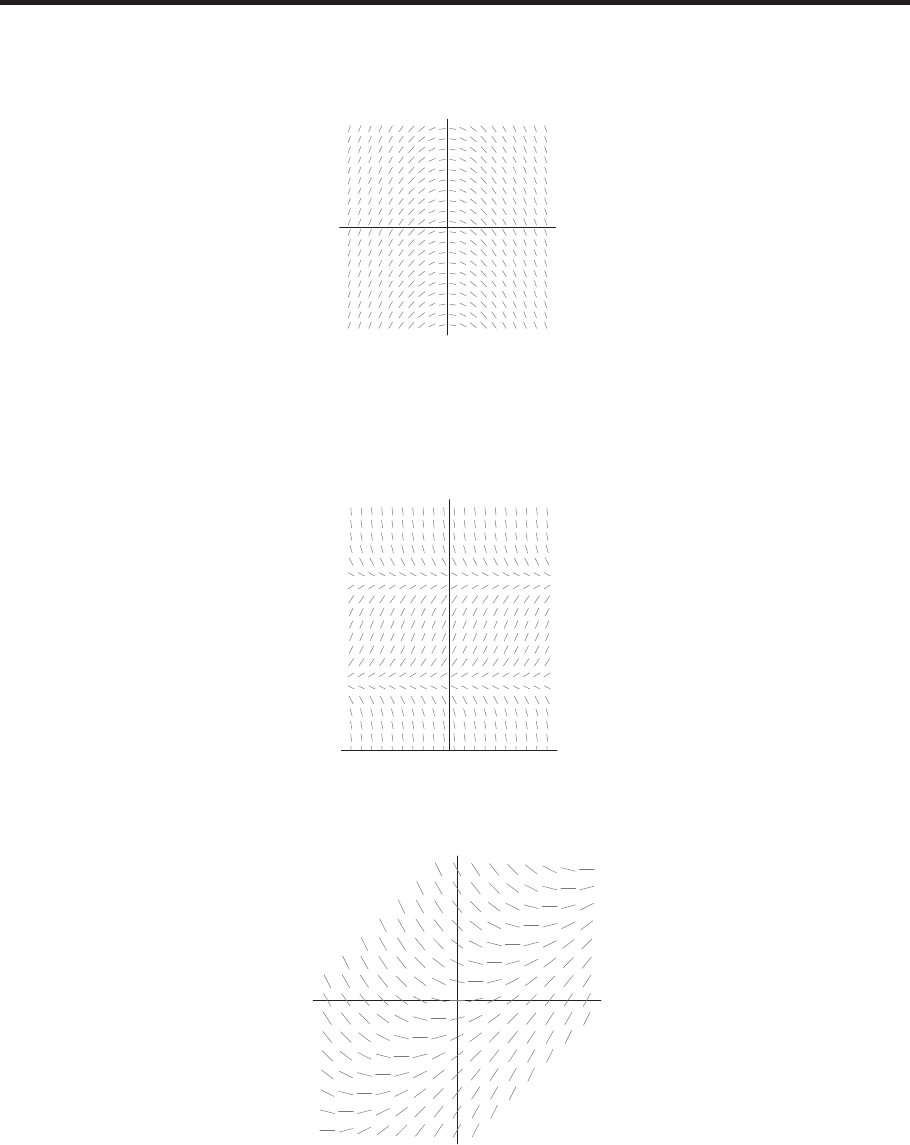
11.2 SOLUTIONS 1025
Problems
10. We draw line segments with positive slope to the left of the y-axis, line segments with negative slope to the right of the
y-axis, and horizontal line segments on the y-axis. A slope field satisfying these conditions is shown in Figure 11.10.
Other answers are possible.
x
y
Figure 11.10
11. We draw line segments with positive slope when Pis between 2 and 5, line segments with negative slope in the sections
below P= 2 and above P= 5, and horizontal line segments on the horizontal lines P= 2 and P= 5. A slope field
satisfying these conditions is shown in Figure 11.11. Other answers are possible.
2
5
t
P
Figure 11.11
12. (a) See Figure 11.12.
Figure 11.12
(b) From the graph, the solution through (1,0) appears linear with the equation approximately y=x−1.
In fact, if y=x−1, then x−y=x−(x−1) = 1 = y′, so y=x−1is the solution through (1,0).
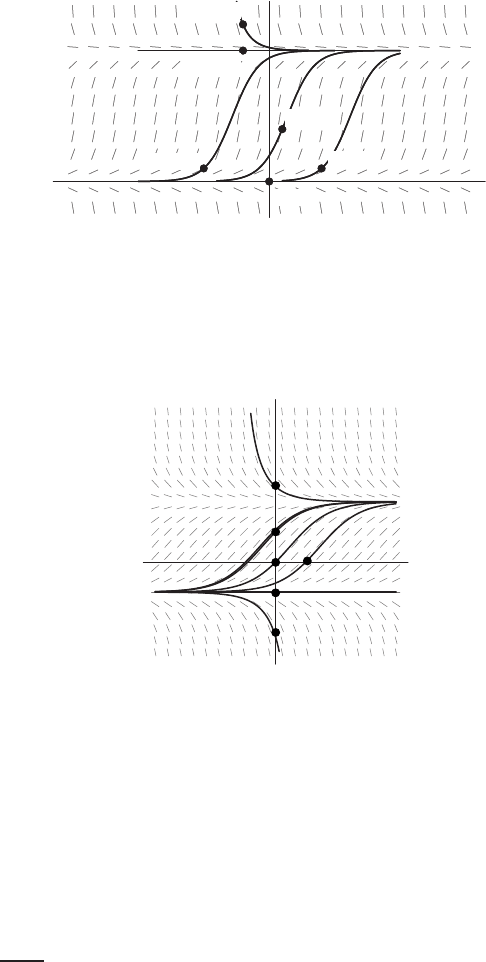
1026 Chapter Eleven /SOLUTIONS
13. (a) See Figure 11.13.
(−5,1)
(−2,10)
(−2,12)
(0,0)
(1,4)
(4,1)
t
P
Figure 11.13
(b) If 0< P < 10, the solution is increasing; if P > 10, it is decreasing. If P(0) = 5, then Ptends to 10.
14. (a) and (b) See Figure 11.14
y
x
(i)
(ii)
(iii)
(iv)
(v)
(vi)
Figure 11.14
(c) Figure 11.14 shows that a solution will be increasing if its y-values fall in the range −1< y < 2. This makes sense
since if we examine the equation y′= 0.5(1 + y)(2 −y),we will find that y′>0if −1< y < 2. Notice that if the
y-value ever gets to 2, then y′= 0 and the function becomes constant, following the line y= 2. (The same is true if
ever y=−1.)
From the graph, the solution is decreasing if y > 2or y < −1. Again, this also follows from the equation, since
in either case y′<0.
The curve has a horizontal tangent if y′= 0, which only happens if y= 2 or y=−1. This also can be seen on
the graph in Figure 11.14.
15. Notice that y′=x+y
x−yis zero when x=−yand is undefined when x=y. A solution curve will be horizontal
(slope= 0) when passing through a point with x=−y, and will be vertical (slope undefined) when passing through a
point with x=y. The only slope field for which this is true is slope field (b).
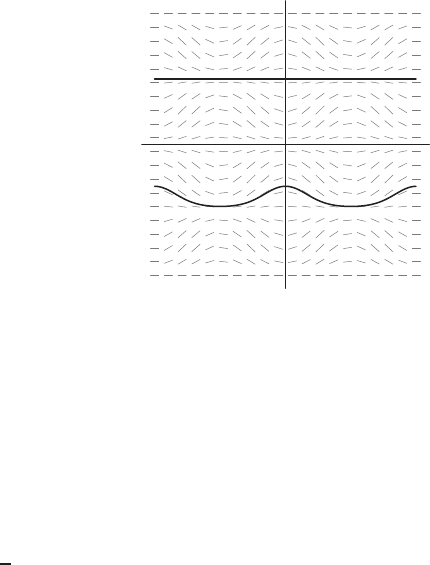
11.2 SOLUTIONS 1027
16. (a) See Figure 11.15.
−6 6
−6
6
x
y
(i)
(ii)
Figure 11.15
(b) We can see that the slope lines are horizontal when yis an integer multiple of π. We conclude from Figure 11.15 that
the solution is y=nπ in this case.
To check this, we note that if y=nπ, then (sin x)(sin y) = (sin x)(sin nπ) = 0 = y′. Thus y=nπ is a
solution to y′= (sin x)(sin y), and it passes through (0, nπ).
17. (a) Since y′=−y, the slope is negative above the x-axis (when yis positive) and positive below the x-axis (when yis
negative). The only slope field for which this is true is II.
(b) Since y′=y, the slope is positive for positive yand negative for negative y. This is true of both I and III. As ygets
larger, the slope should get larger, so the correct slope field is I.
(c) Since y′=x, the slope is positive for positive xand negative for negative x. This corresponds to slope field V.
(d) Since y′=1
y, the slope is positive for positive yand negative for negative y. As yapproaches 0, the slope becomes
larger in magnitude, which corresponds to solution curves close to vertical. The correct slope field is III.
(e) Since y′=y2, the slope is always positive, so this must correspond to slope field IV.
18. The slope fields in (I) and (II) appear periodic. (I) has zero slope at x= 0, so (I) matches y′= sin x, whereas (II) matches
y′= cos x. The slope in (V) tends to zero as x→ ±∞, so this must match y′=e−x2. Of the remaining slope fields,
only (III) shows negative slopes, matching y′=xe−x. The slope in (IV) is zero at x= 0, so it matches y′=x2e−x. This
leaves field (VI) to match y′=e−x.
19. Judging from the figure, we see that:
•The slope depends on y, not on x.
•The slope is positive for y < 0and y > 10.
•The slope is zero at y= 0 and y= 10.
This corresponds to equation (e): y′= 0.05y(y−10).
20. Judging from the figure, we see that:
•The slope depends on y, not on x.
•The slope is positive for 0< y < 10.
•The slope is zero at y= 0 and y= 10.
This corresponds to equation (a): y′= 0.05y(10 −y).
21. Judging from the figure, we see that:
•The slope depends on x, not on y.
•The slope is positive for 0< x < 10.
•The slope is zero at x= 0 and x= 10.
This corresponds to equation (b): y′= 0.05x(10 −x).
22. Judging from the figure, we see that:
•The slope depends on x, not on y.
•The slope is positive for 0< x < 5.
•The slope is zero at x= 0 and x= 5.
This corresponds to equation (d): y′= 0.05x(5 −x).

1028 Chapter Eleven /SOLUTIONS
23. (a) We know that dy
dx =ex2>0for all x. As x→ ∞, the slopes tend toward infinity. Similarly, as x→ −∞, the
slopes tend to infinity. Thus the appropriate slope field is (IV).
(b) We know that dy
dx >0for all x. As x→ ±∞, the slopes tend toward 0. Only slope fields I and III meet these
conditions. We know that when x= 0,dy
dx =e−2x2=e0= 1.
We know that when x= 1,dy
dx =e−2x2=e−2≈0.14. Thus the appropriate slope field is (I).
(c) We know that dy
dx >0for all x. As x→ ±∞, the slopes tend toward 0. Only slope fields I and III meet these
conditions. We know that when x= 0,dy
dx =e−x2/2=e0= 1. We know that when x= 1,dy
dx =e−x2/2=
e−1/2≈0.61. Thus the appropriate slope field is (III).
(d) The slope field is both positive and negative. In fact, when x= 0,dy
dx =e−0.5xcos x=e0cos 0 = 1.
Also, when x= 1,dy
dx =e−0.5xcos x=e−1/2cos 1 ≈0.33, and when x= 2,dy
dx =e−0.5xcos x=
e−1cos 2 ≈ −0.153. Thus the appropriate slope field is (V).
(e) The slope field is positive for all values of x. When x= 0,dy
dx =1
(1 + 0.5 cos x)2≈0.44. Thus the appropriate
slope field is (II).
(f) The slope field is negative for all values of x. Thus the appropriate slope field is (VI).
24. When a= 1 and b= 2, the Gompertz equation is y′=−yln(y/2) = yln(2/y) = y(ln 2 −ln y). This differential
equation is similar to the differential equation y′=y(2 −y)in certain ways. For example, in both equations y′is positive
for 0< y < 2and negative for y > 2. Also, for y-values close to 2, the quantities (ln 2 −ln y)and (2 −y)are both
close to 0, so y(ln 2 −ln y)and y(2 −y)are approximately equal to zero. Thus around y= 2 the slope fields look almost
the same. This happens again around y= 0, since around y= 0 both y(2 −y)and y(ln 2 −ln y)go to 0. (Note that
lim
y→0+(ylny) = 0.) For yvalues close to 1the slope fields look similar since the local linearization of ln ynear y= 1 is
y−1; hence, near y= 1,y(ln 2 −ln y)≈y(ln 2 −(y−1)) ≈y(1.69 −y)≈y(2 −y). Finally, for y > 2,ln ygrows
much slower than y, so the slope field for y′=y(ln 2 −ln y)is less steep, negatively, than for y′=y(2 −y).
Strengthen Your Understanding
25. Since the slope is zero at the point (1,1), the slope field has a horizontal line segment there. On the other hand, the solution
y=xgoes through the point (1,1) with a slope of 1. See Figure 11.16. This is impossible since the slope field is tangent
to the solution curves.
1
1
x
y
Figure 11.16
26. Note that y′=yhas a slope field with all positive slopes when y > 0. The given slope field, however, has negative slopes
in the second quadrant.
27. If the slopes are all positive, then dy/dx is always positive. Some examples are dy/dx =x2+ 1 or dy/dx =y2+ 1 or
dy/dx =x2+y2+ 1 or dy/dx =ex.
28. The sign of the derivative depends on the y-coordinate, since the y-coordinate determines whether a point is above or
below the x-axis. Since we want a positive derivative when yis positive and a negative derivative when yis negative, one
example is dy/dx =y.

11.2 SOLUTIONS 1029
29. If a derivative dy/dx depends only on x, then the derivative is constant for any fixed value of x. In other words, the slope
is the same for all points on any vertical line. One possibility is the slope field for dy/dx =xin Figure 11.17.
x
y
Figure 11.17
30. If a derivative dy/dx depends only on y, then the derivative is constant for any fixed value of y. In other words, the slope
is the same for all points on any horizontal line. One possibility is the slope field for dy/dx =yin Figure 11.18.
x
y
Figure 11.18
31. False. If y(0) ≤0, then limx→∞ y=−∞.
32. True. No matter what initial value you pick, the solution curve has the x-axis as an asymptote.
33. False. There appear to be two equilibrium values dividing the plane into regions with different limiting behavior.
34. True. We have dy/dx > 0at every point because x2+y2+ 1 >0, and a positive derivative indicates increasing function.
35. False. We have
d2y
dx2=d(x2+y2+ 1)
dx
= 2x+ 2ydy
dx
= 2x+ 2y(x2+y2+ 1)
= 2x+ 2y+ 2x2y+ 2y3.
At the point (x, y) = (−1,0) we have d2y/dx2=−2<0. A negative second derivative indicates function concave
down. The solution curve of the differential equation that passes through the point (−1,0) is concave down at (−1,0).
36. True. The slope of the graph of fis dy/dx = 2x−y. Thus when x=aand y=b, the slope is 2a−b.
37. True. Saying y=f(x)is a solution for the differential equation dy/dx = 2x−ymeans that if we substitute f(x)for y,
the equation is satisfied. That is, f′(x) = 2x−f(x).
38. False. Since f′(x) = 2x−f(x), we would have 1 = 2x−5so x= 3 is the only possibility.
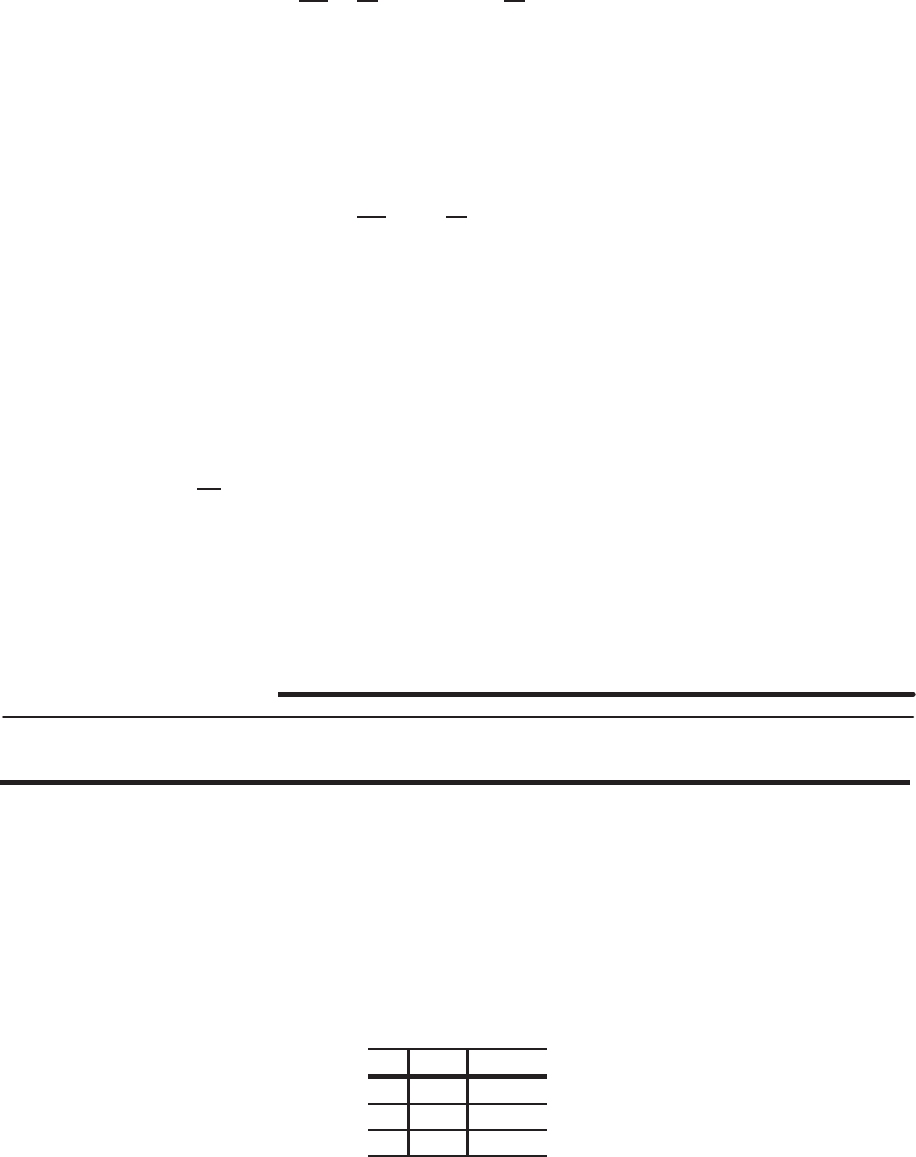
1030 Chapter Eleven /SOLUTIONS
39. True. Differentiate dy/dx = 2x−y, to get:
d2y
dx2=d
dx (2x−y) = 2 −dy
dx = 2 −(2x−y).
40. False. Since f′(1) = 2(1) −5 = −3, the point (1,5) could not be a critical point of f.
41. True. Since dy/dx = 2x−y, the slope of the graph of fis negative at any point satisfying 2x < y, that is any point
lying above the line y= 2x. The slope of the graph of fis positive at any point satisfying 2x > y, that is any point lying
below the line y= 2x.
42. True. When we differentiate dy/dx = 2x−y, we get:
d2y
dx2= 2 −dy
dx = 2 −(2x−y).
Thus at any inflection point of y=f(x), we have d2y/dx2= 2 −(2x−y) = 0. That is, any inflection point of fmust
satisfy y= 2x−2.
43. False. Suppose that g(x) = f(x) + C, where C6= 0. In order to be a solution of dy/dx = 2x−ywe would need
g′(x) = 2x−g(x). Instead we have:
g′(x) = f′(x) = 2x−f(x) = 2x−(g(x)−C) = 2x−g(x) + C.
Since C6= 0, this means g(x)is not a solution of dy/dx = 2x−y.
44. True. We will use the hint. Let w=g(x)−f(x). Then:
dw
dx =g′(x)−f′(x) = (2x−g(x)) −(2x−f(x)) = f(x)−g(x) = −w.
Thus dw/dx =−w. This equation is the equation for exponential decay and has the general solution w=Ce−x. Thus,
lim
x→∞(g(x)−f(x)) = lim
x→∞ Ce−x= 0.
Solutions for Section 11.3
Exercises
1. Using Euler’s method, we have:
At (x, y) = (0,4):y′= (0 −2)(4 −3) = −2
so at x= 0.1:y= 4.0−2(0.1) = 3.8because ∆x= 0.1
At (x, y) = (0.1,3.8):y′= (0.1−2)(3.8−3) = −1.52
so at x= 0.2:y= 3.8−1.52(0.1) = 3.648 because ∆x= 0.1
At (x, y) = (0.2,3.648):y′= (0.2−2)(3.648 −3) = −1.1664.
Thus, the completed table is
x y y′
0.0 4.0−2
0.1 3.8−1.52
0.2 3.648 −1.1664
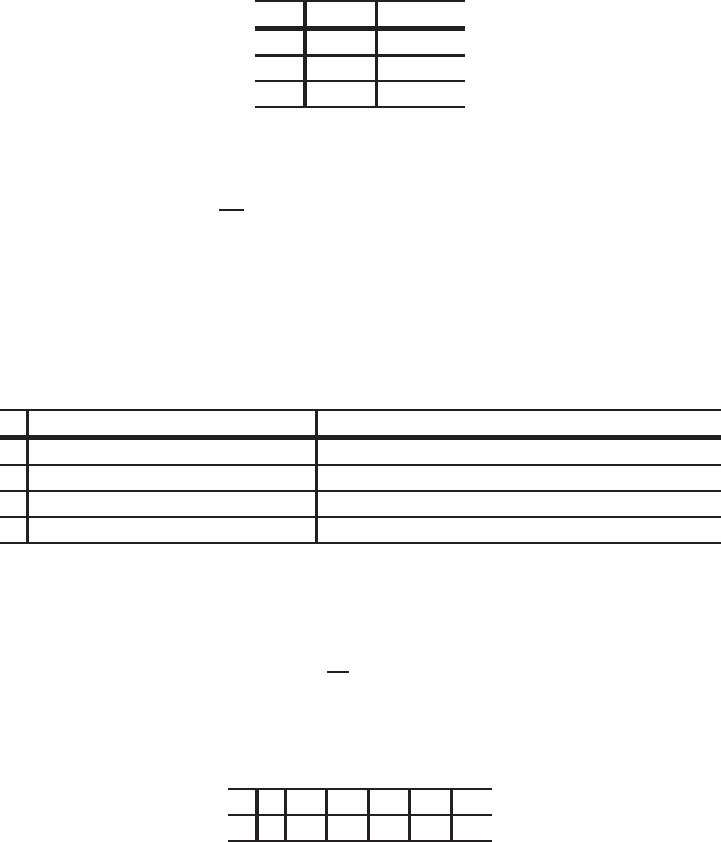
11.3 SOLUTIONS 1031
2. Using Euler’s method, we have:
At (x, y) = (1,−3):y′= 4(1)(−3) = −12
so at x= 1.01:y=−3−12(0.01) = −3.12 because ∆x= 0.01
At (x, y) = (1.01,−3.12):y′= 4(1.01)(−3.12) = −12.6048
so at x= 1.02:y=−3.12 −12.6048(0.01) = −3.246 because ∆x= 0.01
At (x, y) = (1.02,−3.246):y′= 4(1.02)(−3.246) = −13.244.
Thus, the completed table is
x y y′
1.00 −3−12
1.01 −3.12 −12.6048
1.02 −3.246 −13.244
3. We know P= 1500 at time t= 0. This means
dP
dt = 0.00008(1500)(1900 −1500) = 48.
From time t= 0 to t= 1 we have ∆t= 1, so the new value of Pis given by
Value of P
at t= 1 = 1500 + 48(1) = 1548.
We repeat this process to find the values of Pat t= 2 and t= 3. See the table.
t P dP/ dt
0 1500 0.00008(1500)(1900 −1500) = 48
1 1500 + 48(1) = 1548 0.00008(1548)(1900 −1548) = 43.59168
2 1548 + 43.59168(1) = 1591.59168 0.00008(1591.59168)(1900 −1591.59168) = 39.26881
3 1591.59168 + 39.26881 = 1630.86049 (no calculation necessary)
Rounding gives values of P= 1548, P = 1591.5917, P = 1630.860 at t= 1,2,3.
4. (a) Since dy/dx is always 3 and ∆x= 0.2, at every step we have
∆y=dy
dx ·∆x= 3(0.2) = 0.6.
The results are in Table 11.2. We see that Euler’s method gives an approximate value of y= 5 at x= 1.
Table 11.2
x00.2 0.4 0.6 0.8 1.0
y22.6 3.2 3.8 4.4 5
(b) The general solution to dy/dx = 3 is y= 3x+C. We use the initial condition to see that C= 2 so the particular
solution is y= 3x+ 2.
(c) The exact value of the solution at x= 1 is y= 3(1) + 2 = 5. Since the approximate value from Euler’s method is
also 5, the error is 0.
(d) Euler’s method approximates a solution using line segments. Since in this case the exact solution is itself a line,
Euler’s method gives exact values.
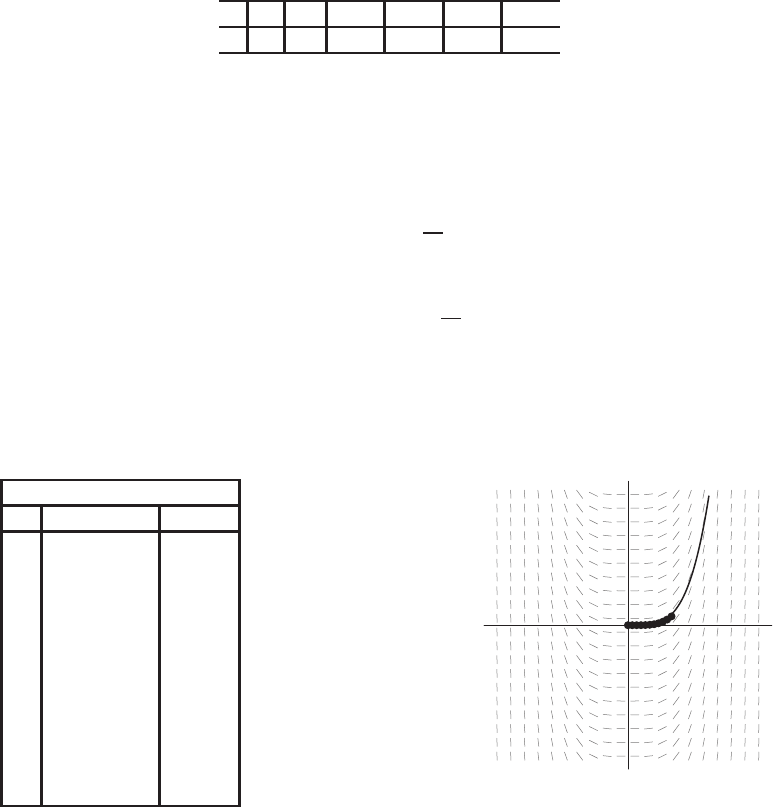
1032 Chapter Eleven /SOLUTIONS
5. (a) At point P0= (0,10), we have
∆y=slope at P0·∆x= (10 −0)(0.2) = 2.
Therefore, point P1is (0.2,12). At point P1, we have
∆y=slope at P1·∆x= (12 −0.2)(0.2) = 2.36.
So point P2is (0.4,14.36). Continuing in this way, we obtain the approximate solution shown in Table 11.3.
Table 11.3
x00.2 0.4 0.6 0.8 1.0
y10 12 14.36 17.15 20.46 24.39
(b) Since the slopes are getting larger, we expect the solution to be concave up.
(c) Since the solution is concave up, we expect our approximations to be underestimates. It can be shown that the true
value of yat x= 1 is 26.46.
6. (a) The results from Euler’s method with ∆x= 0.1are in Table 11.4.
(b) We have
y(x) = x4
4+C,
so that y(0) = 0 gives C= 0, and the required solution is therefore
y(x) = x4
4.
This is shown in the 3rd column of Table 11.4.
(c) The computed solution underestimates the real solution since the solution is concave up and is approximated in every
interval by the tangent which is beneath the curve. See Figure 11.19.
Table 11.4
Computed Solution
xnApprox. y(xn)y(xn)
0 0 0
0.1 0 0.000025
0.2 0.0001 0.0004
0.3 0.0009 0.002025
0.4 0.0036 0.0064
0.5 0.01 0.015625
0.6 0.0225 0.0324
0.7 0.0441 0.060025
0.8 0.0784 0.1024
0.9 0.1296 0.164025
1.0 0.2025 0.25
x
y
Figure 11.19
7. (a) In Table 11.5, we see that y(0.4) ≈1.5282.
(b) In Table 11.6, we see that y(0.4) = −1.4. (This answer is exact.)
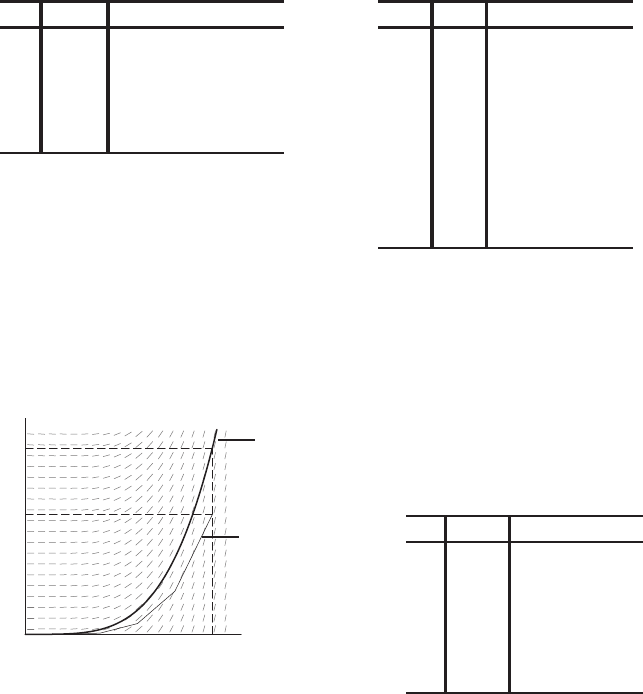
11.3 SOLUTIONS 1033
Table 11.5
Euler’s method for
y′=x+ywith y(0) = 1
x y ∆y=(slope)∆x
0 1 0.1 = (1)(0.1)
0.11.1 0.12 = (1.2)(0.1)
0.21.22 0.142 = (1.42)(0.1)
0.31.362 0.1662 = (1.662)(0.1)
0.41.5282
Table 11.6
Euler’s method for
y′=x+ywith y(−1) = 0
x y ∆y=(slope)∆x
−1 0 −0.1 = (−1)(0.1)
−0.9−0.1−0.1 = (−1)(0.1)
−0.8−0.2−0.1 = (−1)(0.1)
−0.7−0.3
.
.
.
.
.
.Notice that y
0−1decreases by 0.1
.
.
.
.
.
. for every step
0.4−1.4
8. (a) See Figure 11.20.
(b) See Table 11.7. At x= 1, Euler’s method gives y≈0.16.
(c) Our answer to (a) appears to be an underestimate. This is as we would expect, since the solution curve is concave up.
1
0.16
0.25 ✛
True
answer
✛
Approximation
x
y
Figure 11.20
Table 11.7
x y ∆y=(slope)∆x
0 0 0
0.2 0 0.0016
0.4 0.0016 0.0128
0.6 0.0144 0.0432
0.8 0.0576 0.1024
1 0.1600
9. (a) See Figure 11.21.
(b) y(0) = 1,
y(0.1) ≈y(0) + 0.1y(0) = 1 + 0.1(1) = 1.1
y(0.2) ≈y(0.1) + 0.1y(0.1) = 1.1 + 0.1(1.1) = 1.21
y(0.3) ≈y(0.2) + 0.1y(0.2) = 1.21 + 0.1(1.21) = 1.331
y(0.4) ≈1.4641
y(0.5) ≈1.61051
y(0.6) ≈1.77156
y(0.7) ≈1.94872
y(0.8) ≈2.14359
y(0.9) ≈2.35795
y(1.0) ≈2.59374
(c) See Figure 11.21. A smooth curve drawn through the solution points seems to match the slope field.
(d) For y=ex, we have y′=ex=yand y(0) = e0= 1. See Table 11.8.
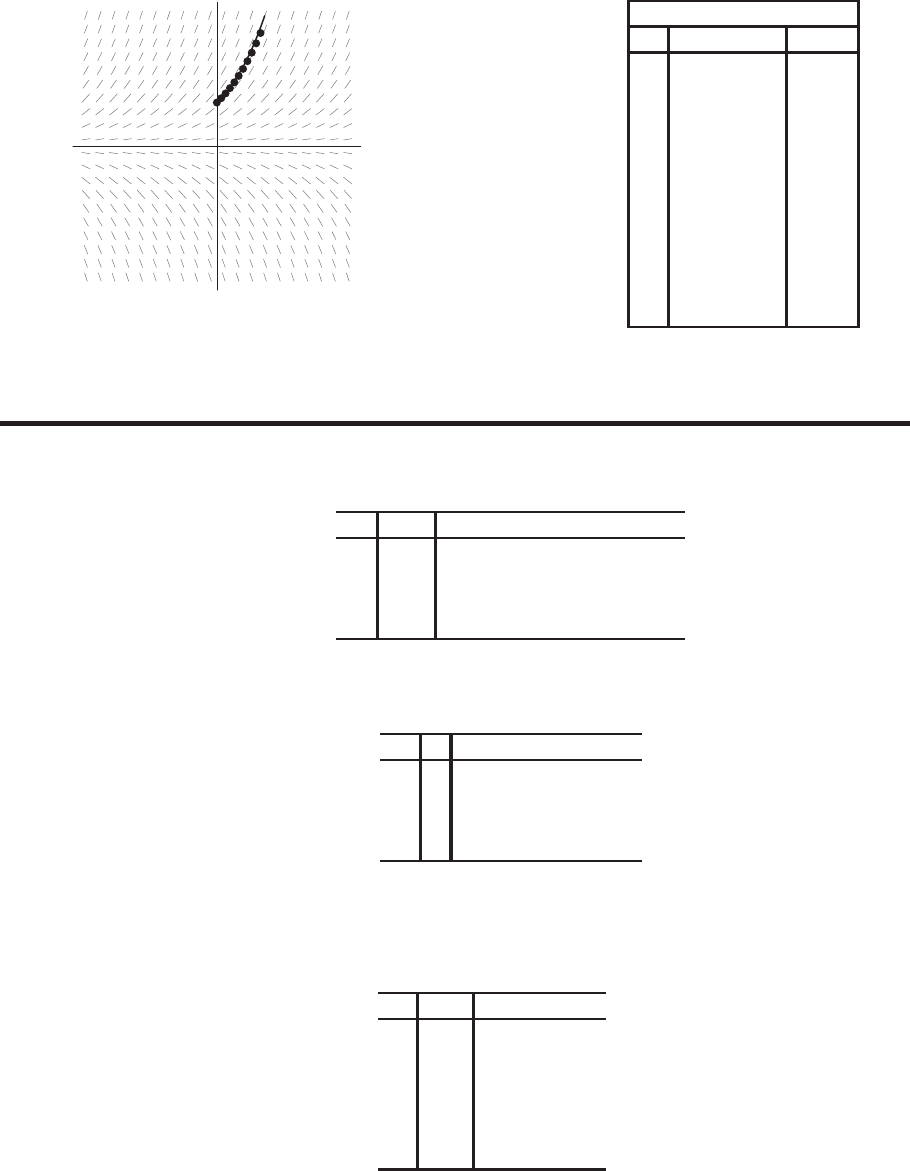
1034 Chapter Eleven /SOLUTIONS
Figure 11.21
Table 11.8
Computed Solution
xnApprox. y(xn)y(xn)
0 1 1
0.1 1.1 1.10517
0.2 1.21 1.22140
0.3 1.331 1.34986
0.4 1.4641 1.49182
0.5 1.61051 1.64872
0.6 1.77156 1.82212
0.7 1.94872 2.01375
0.8 2.14359 2.22554
0.9 2.35795 2.45960
1.0 2.59374 2.71828
Problems
10. (a) (i)
Table 11.9
Euler’s method for
y′= (sin x)(sin y), starting at (0,2)
x y ∆y=(slope)∆x
0 2 0 = (sin 0)(sin 2)(0.1)
0.12 0.009 = (sin 0.1)(sin 2)(0.1)
0.22.009 0.018 = (sin 0.2)(sin 2.009)(0.1)
0.3 2.027
(ii)
Table 11.10
Euler’s method for
y′= (sin x)(sin y), starting at (0, π)
x y ∆y=(slope)∆x
0π0 = (sin 0)(sin π)(0.1)
0.1π0 = (sin 0.1)(sin π)(0.1)
0.2π0 = (sin 0.2)(sin π)(0.1)
0.3π
(b) The slope field shows that the slope of the solution curve through (0, π)is always 0. Thus the solution curve is the
horizontal line with equation y=π.
11. (a)
Table 11.11
x y ∆y=(slope)∆x
0 1.000 −0.200
0.2 0.800 −0.120
0.4 0.680 −0.060
0.6 0.620 −0.005
0.8 0.615 0.052
10.667
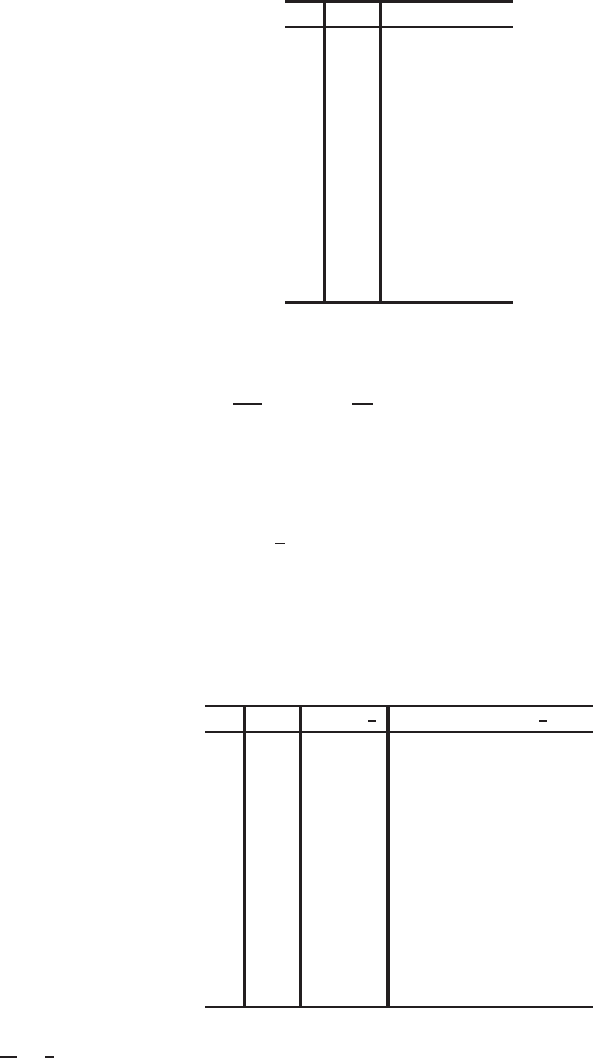
11.3 SOLUTIONS 1035
(b)
Table 11.12
x y ∆y=(slope)∆x
0 1.000 −0.100
0.1 0.900 −0.080
0.2 0.820 −0.063
0.3 0.757 −0.048
0.4 0.709 −0.034
0.5 0.674 −0.020
0.6 0.654 −0.007
0.7 0.647 0.007
0.8 0.654 0.021
0.9 0.675 0.035
10.710
12. By looking at the slope fields, or by computing the second derivative
d2y
dx2= 2x−2ydy
dx = 2x−2x2y+ 2y3,
we see that the solution curve is concave up, so Euler’s method gives an underestimate.
13. Since the error is proportional to one over the number of subintervals, the error using 10 intervals should be roughly half
the error obtained using 5 intervals. Since both the estimates are underestimates, if we let Abe the actual value we have:
1
2(A−0.667) = A−0.710
A−0.667 = 2A−1.420
A= 0.753
Therefore, 0.753 should be a better approximation.
14. (a)
Table 11.13
t y slope =1
t∆y= (slope)∆t=1
t(0.1)
1 0 1 0.1
1.1 0.1 0.909 0.091
1.2 0.191 0.833 0.083
1.3 0.274 0.769 0.077
1.4 0.351 0.714 0.071
1.5 0.422 0.667 0.067
1.6 0.489 0.625 0.063
1.7 0.552 0.588 0.059
1.8 0.610 0.556 0.056
1.9 0.666 0.526 0.053
2 0.719
(b) If dy
dt =1
t, then y= ln |t|+C.
Starting at (1,0) means y= 0 when t= 1, so C= 0 and y= ln |t|.
After ten steps, t= 2,so y= ln 2 ≈0.693.
(c) Approximate y= 0.719, Exact y= 0.693.
Thus the approximate answer is too big. This is because the solution curve is concave down, and so the tangent lines
are above the curve. Figure 11.22 shows the slope field of y′= 1/t with the solution curve y= ln tplotted on top of
it.
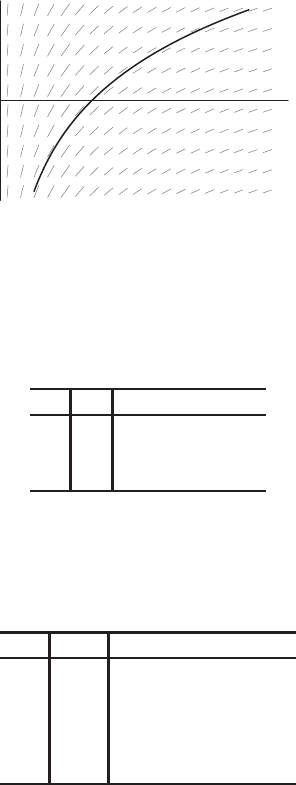
1036 Chapter Eleven /SOLUTIONS
1t
y
Figure 11.22
15. (a) ∆x= 0.5
Table 11.14
Euler’s method for
y′= 2x, with y(0) = 1
x y ∆y=(slope)∆x
0 1 0 = (2 ·0)(0.5)
0.5 1 0.5 = (2 ·0.5)(0.5)
11.5
∆x= 0.25
Table 11.15
Euler’s method for
y′= 2x, with y(0) = 1
x y ∆y=(slope)∆x
0 1 0 = (2 ·0)(0.25)
0.25 1 0.125 = (2 ·0.25)(0.25)
0.50 1.125 0.25 = (2 ·0.5)(0.25)
0.75 1.375 0.375 = (2 ·0.75)(0.25)
11.75
(b) General solution is y=x2+C, and y(0) = 1 gives C= 1. Thus, the solution is y=x2+ 1. So the true value of y
when x= 1 is y= 12+ 1 = 2.
(c) When ∆x= 0.5, error = 0.5.
When ∆x= 0.25, error = 0.25.
Thus, decreasing ∆xby a factor of 2has decreased the error by a factor of 2, as expected.
16. For ∆x= 0.2, we get the following results.
y(1.2) ≈y(1) + 0.2 sin(1 ·y(1)) = 1.168294
y(1.4) ≈y(1.2) + 0.2 sin(1.2·y(1.2)) = 1.365450
y(1.6) ≈y(1.4) + 0.2 sin(1.4·y(1.4)) = 1.553945
y(1.8) ≈y(1.6) + 0.2 sin(1.6·y(1.6)) = 1.675822
y(2.0) ≈y(1.8) + 0.2 sin(1.8·y(1.8)) = 1.700779
Repeating this with ∆x= 0.1and 0.05 gives the results in Table 11.16 below
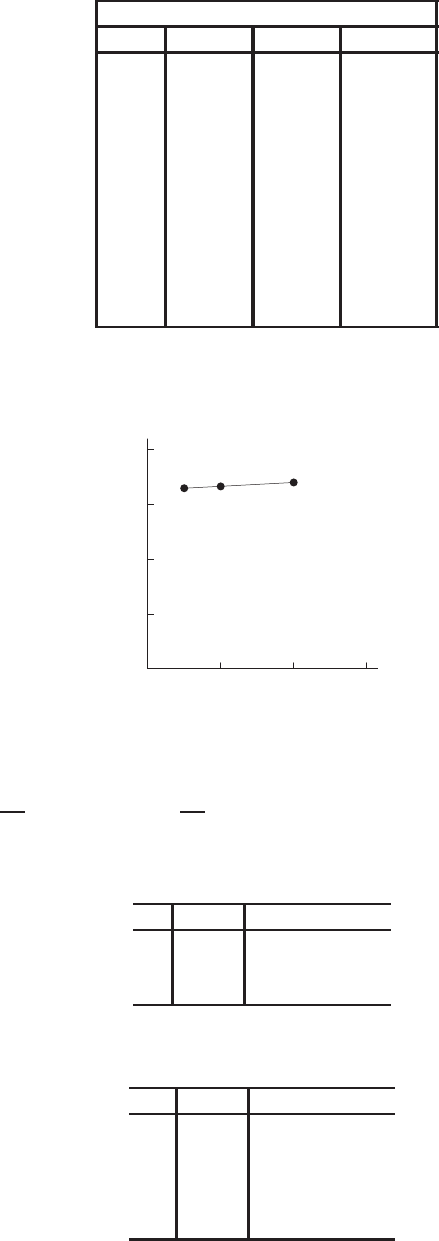
11.3 SOLUTIONS 1037
Table 11.16
Computed Solution
x-value ∆x= 0.2 ∆x= 0.1 ∆x= 0.05
1.0 1 1 1
1.1 1.084147 1.086501
1.2 1.168294 1.177079 1.181232
1.3 1.275829 1.280619
1.4 1.365450 1.375444 1.379135
1.5 1.469214 1.469885
1.6 1.553945 1.549838 1.546065
1.7 1.611296 1.602716
1.8 1.675822 1.650458 1.637809
1.9 1.667451 1.652112
2.0 1.700779 1.664795 1.648231
The computed approximations for y(2) using step sizes ∆x= 0.2,0.1,0.05 are 1.700779,1.664795, and 1.648231,
respectively. Plotting these points we see that they lie approximately on a straight line.
0.1 0.2 0.3
0.5
1
1.5
2
∆x
y(2)
Figure 11.23
In the limit, as ∆xtends to zero, the results produced by Euler’s method should converge to the exact value of y(2).
This limiting value is the vertical intercept of the line drawn in Figure 11.23. This gives y(2) ≈1.632.
17. (a) Using one step, ∆B
∆t= 0.05, so ∆B=∆B
∆t∆t= 50. Therefore we get an approximation of B≈1050 after one
year.
(b) With two steps, ∆t= 0.5and we have
Table 11.17
t B ∆B= (0.05B)∆t
0 1000 25
0.5 1025 25.63
1.0 1050.63
(c) Keeping track to the nearest hundredth with ∆t= 0.25, we have
Table 11.18
t B ∆B= (0.05B)∆t
0 1000 12.5
0.25 1012.5 12.66
0.5 1025.16 12.81
0.75 1037.97 12.97
11050.94
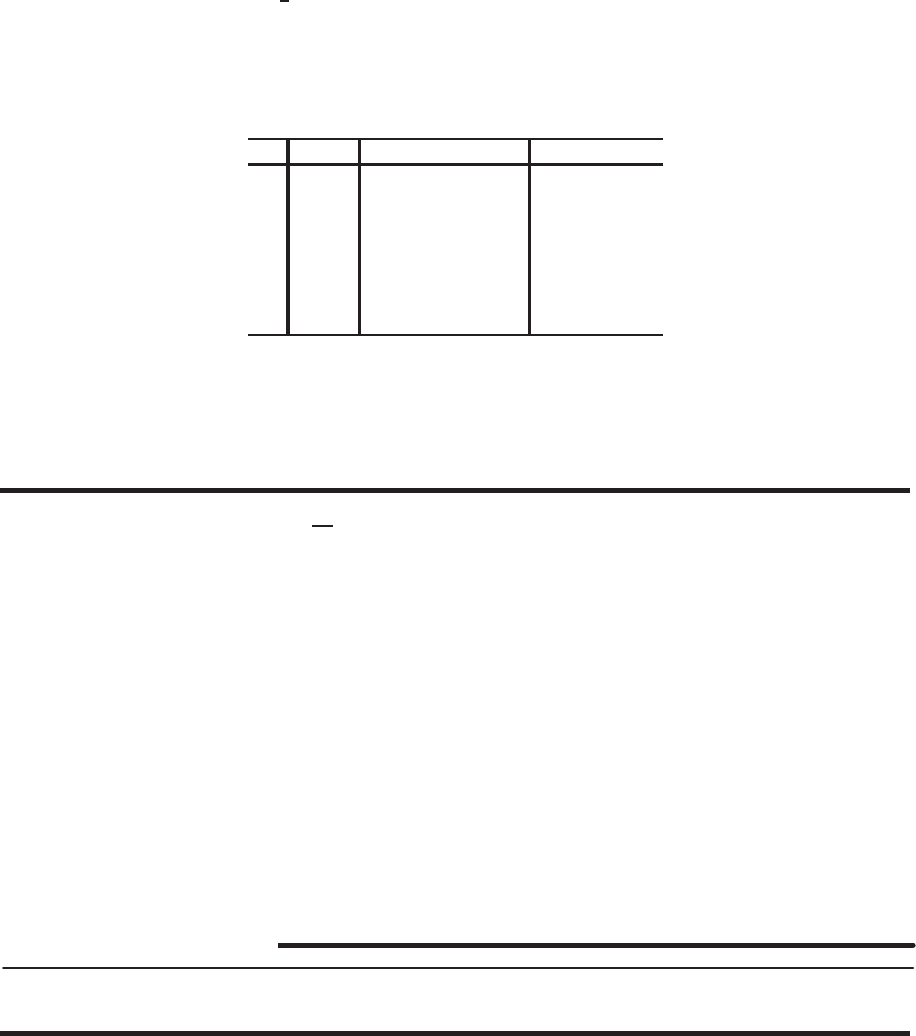
1038 Chapter Eleven /SOLUTIONS
(d) In part (a), we get our approximation by making a single increment, ∆B, where ∆Bis just 0.05B. If we think in
terms of interest, ∆Bis just like getting one end of the year interest payment. Since ∆Bis 0.05 times the balance
B, it is like getting 5% interest at the end of the year.
(e) Part (b) is equivalent to computing the final amount in an account that begins with $1000 and earns 5% interest
compounded twice annually. Each step is like computing the interest after 6 months. When t= 0.5, for example, the
interest is ∆B= (0.05B)·1
2, and we add this to $1000 to get the new balance.
Similarly, part (c) is equivalent to the final amount in an account that has an initial balance of $1000 and earns
5% interest compounded quarterly.
18. Assume that x > 0and that we use nsteps in Euler’s method. Label the x-coordinates we use in the process
x0, x1,...,xn, where x0= 0 and xn=x. Then using Euler’s method to find y(x), we get
Table 11.19
x y ∆y=(slope)∆x
P00 = x00f(x0)∆x
P1x1f(x0)∆x f(x1)∆x
P2x2f(x0)∆x+f(x1)∆x f(x2)∆x
.
.
.
.
.
.
.
.
.
.
.
.
Pnx=xn
n−1
X
i=0
f(xi)∆x
Thus the result from Euler’s method is
n−1
X
i=0
f(xi)∆x. We recognize this as the left-hand Riemann sum that approxi-
mates Rx
0f(t)dt.
Strengthen Your Understanding
19. For differential equations of the form dy
dx =k, where kis constant, Euler’s method traces the exact solution for any initial
condition.
20. If x(0) >0, then the statement is true. However, if x(0) <0, then the solution curve is decreasing. Since we are using the
value of xat the beginning of a subinterval to estimate the rate of change of xon an interval, we obtain an overestimate
for x(1).
21. The approximate values lie on a line if the slope ∆y/∆xis constant, which occurs if dy/dx is constant. One example is
dy/dx = 5. The approximate values found using Euler’s method lie on a line for any initial condition and value of ∆x.
Other examples are possible.
22. One step of Euler’s method gives an underestimate when the solution is concave up. Thus, we look for a differential
equation whose solution curves are concave up everywhere. An example is given by the equation dy/dx =ywith
y(0) = 1 which has solution y=ex.
23. False. Euler’s method approximates y-values of points on the solution curve.
24. True. Both lead to
y(1) ≈f(0) ·0.2 + f(0.2) ·0.2 + f(0.4) ·0.2 + f(0.6) ·0.2 + f(0.8) ·0.2.
Solutions for Section 11.4
Exercises
1. (a) Yes (b) No (c) Yes
(d) No (e) Yes (f) Yes
(g) No (h) Yes (i) No
(j) Yes (k) Yes (l) No

11.4 SOLUTIONS 1039
2. Separating variables gives Z1
PdP =−Z2dt,
so
ln |P|=−2t+C.
Therefore
P=±e−2t+C=Ae−2t.
The initial value P(0) = 1 gives 1 = A, so
P=e−2t.
3. Separating variables gives ZdP
P=Z0.02 dt,
so
ln |P|= 0.02t+C.
Thus
|P|=e0.02t+C
and
P=Ae0.02t,where A=±eC.
We are given P(0) = 20. Therefore, P(0) = Ae(0.02)·0=A= 20. So the solution is
P= 20e0.02t.
4. Separating variables and integrating both sides gives
Z1
LdL =1
2Zdp
or
ln |L|=1
2p+C.
This can be written
L=±e(1/2)p+C=Aep/2.
The initial condition L(0) = 100 gives 100 = A, so
L= 100ep/2.
5. Separating variables gives ZdQ
Q=Zdt
5,
so
ln |Q|=1
5t+C.
So
|Q|=e1
5t+C=e1
5teC
and
Q=Ae 1
5t,where A=±eC.
From the initial conditions we know that Q(0) = 50, so Q(0) = Ae(1
5)·0=A= 50. Thus
Q= 50e1
5t.

1040 Chapter Eleven /SOLUTIONS
6. Separating variables gives ZP dP =Zdt
so that
P2
2=t+C
or
P=±√2t+D
(where D= 2C).
The initial condition P(0) = 1 implies we must take the positive root and that 1 = D, so
P=√2t+ 1.
7. Separating variables gives
Zdm
m=Z3dt
ln |m|= 3t+C
m=±eCe3t=Ae3t.
Since m= 5 when t= 1,we have 5 = Ae3,so A= 5/e3.Thus
m=5
e3e3t= 5e3t−3.
8. Separating variables gives ZdI
I=Z0.2dx,
so
ln |I|= 0.2x+C.
Thus,
I=Ae0.2x,where A=±eC.
According to the given boundary condition, I(−1) = 6. Therefore, I(−1) = Ae0.2(−1) =Ae−0.2= 6, so A= 6e0.2.
Thus
I= 6e0.2e0.2x= 6e0.2(x+1).
9. Separating variables gives
Zdz
z=Z5dt
ln |z|= 5t+C.
Solving for z, we have
z=Ae5t,where A=±eC.
Using the fact that z(1) = 5,we have z(1) = Ae5= 5,so A= 5/e5.Therefore,
z=5
e5e5t= 5e5t−5.
10. Separating variables gives Z1
mdm =Zds.
Hence
ln |m|=s+C

11.4 SOLUTIONS 1041
which gives
m=±es+C=Aes.
The initial condition m(1) = 2 gives 2 = Ae1or A= 2/e, so
m=2
ees= 2es−1.
11. Separating variables gives Z1
u2du =Z1
2dt
or
−1
u=1
2t+C.
The initial condition gives C=−1and so
u=1
1−(1/2)t.
12. Separating variables and integrating gives Z1
zdz =Zydy
which gives
ln |z|=1
2y2+C
or
z=±e(1/2)y2+C=Aey2/2.
The initial condition y= 0,z= 1 gives A= 1. Therefore
z=ey2/2.
13. Separating variables gives
Zdy
y=−Z1
3dx
ln |y|=−1
3x+C.
Solving for y, we have
y=Ae−1
3x,where A=±eC.
Since y(0) = A= 10,we have
y= 10e−1
3x.
14. Separating variables gives
Zdy
y−200 =Z0.5dt
ln |y−200|= 0.5t+C
y= 200 + Ae0.5t,where A=±eC.
The initial condition, y(0) = 50, gives
50 = 200 + A, so A=−150.
Thus,
y= 200 −150e0.5t.

1042 Chapter Eleven /SOLUTIONS
15. Separating variables gives ZdP
P+ 4 =Zdt,
so
ln |P+ 4|=t+C
P+ 4 = Aet
P=Aet−4.
Since P= 100 when t= 0,we have P(0) = Ae0−4 = 100,and A= 104.Therefore
P= 104et−4.
16. Factoring out a 2 on the right makes the integration easier:
dy
dx = 2y−4 = 2(y−2)
Zdy
y−2=Z2dx,
giving
ln |y−2|= 2x+C.
Thus,
|y−2|=e2x+C,
so
y−2 = Ae2x, where A=±eC.
The curve passes through (2,5), which means 3 = Ae4,so A= 3/e4.Thus,
y= 2 + 3
e4e2x= 2 + 3e2x−4.
17. Factoring and separating variables gives
dQ
dt = 0.3(Q−400)
ZdQ
Q−400 =Z0.3dt
ln |Q−400|= 0.3t+C
Q= 400 + Ae0.3t,where A=±eC.
The initial condition, Q(0) = 50, gives
50 = 400 + Aso A=−350.
Thus
Q= 400 −350e0.3t.
18. Factoring out the 0.1 gives
dm
dt = 0.1m+ 200 = 0.1(m+ 2000)
Zdm
m+ 2000 =Z0.1dt,
so
ln |m+ 2000|= 0.1t+C,

11.4 SOLUTIONS 1043
and
m=Ae0.1t−2000,where A=±eC.
Using the initial condition, m(0) = Ae(0.1)·0−2000 = 1000,gives A= 3000.Thus
m= 3000e0.1t−2000.
19. Rearrange and write Z1
1−RdR =Zdy
or
−ln |1−R|=y+C
which can be written as
1−R=±e−C−y=Ae−y
or
R= 1 −Ae−y.
The initial condition R(1) = 0.1gives 0.1 = 1 −Ae−1and so
A= 0.9e.
Therefore
R= 1 −0.9e1−y.
20. Rewriting gives
dB
dt + 2B= 50
and dB
dt =−2B+ 50 = −2(B−25),
so
ZdB
B−25 =−Z2dt
ln |B−25|=−2t+C.
Thus, we have
B−25 = Ae−2t,where A=±eC.
Using the initial condition, B(1) = 100, we have 75 = Ae−2,so A= 75e2.Thus
B= 25 + 75e2e−2t= 25 + 75e2−2t.
21. Write Z1
ydy =Z1
3 + tdt
and so
ln |y|= ln |3 + t|+C
or
ln |y|= ln D|3 + t|
where ln D=C. Therefore
y=D(3 + t).
The initial condition y(0) = 1 gives D=1
3, so
y=1
3(3 + t).

1044 Chapter Eleven /SOLUTIONS
22. Separating variables gives
dz
dt =tez
e−zdz =tdt
Ze−zdz =Zt dt,
so
−e−z=t2
2+C.
Since the solution passes through the origin, z= 0 when t= 0, we must have
−e−0=0
2+C, so C=−1.
Thus
−e−z=t2
2−1,
or
z=−ln 1−t2
2.
23. Separating variables gives
dy
dx =5y
x
Zdy
y=Z5
xdx
ln |y|= 5 ln |x|+C.
Thus
|y|=e5 ln |x|eC=eCeln |x|5=eC|x|5,
giving
y=Ax5,where A=±eC.
Since y= 3 when x= 1, so A= 3. Thus
y= 3x5.
24. Separating variables gives
dy
dt =y2(1 + t)
Zdy
y2=Z(1 + t)dt,
so
−1
y=t+t2
2+C,
giving
y=−1
t+t2/2 + C.
Since y= 2 when t= 1, we have
2 = −1
1 + 1/2 + C,so 2C+ 3 = −1,and C=−2.
Thus
y=−1
t2/2 + t−2=−2
t2+ 2t−4.

11.4 SOLUTIONS 1045
25. Separating variables gives
dz
dt =z+zt2=z(1 + t2)
Zdz
z=Z(1 + t2)dt,
so
ln |z|=t+t3
3+C,
giving
z=Aet+t3/3.
We have z= 5 when t= 0,so A= 5 and
z= 5et+t3/3.
26. Separating variables gives
dw
dθ =θw2sin θ2
Zdw
w2=Zθsin θ2dθ,
so
−1
w=−1
2cos θ2+C.
According to the initial conditions, w(0) = 1,so −1 = −1
2+Cand C=−1
2.Thus,
−1
w=−1
2cos θ2−1
2
1
w=cos θ2+ 1
2
w=2
cos θ2+ 1 .
27. Separating variables and integrating gives
Z1
w2dw =−Ztan ψdψ.
To integrate the right side, write tan ψ= sin ψ/ cos ψand use the substitution w= cos ψgiving
−1
w= ln |cos ψ|+C
so
w=−1
ln |cos ψ|+C.
Using the initial condition w(0) = 2 we have
2 = −1
ln |cos 0|+C=−1
ln 1 + C=−1
0 + C
so
C=−1
2.
Thus the solution is
w=−1
ln |cos ψ| − 1/2.
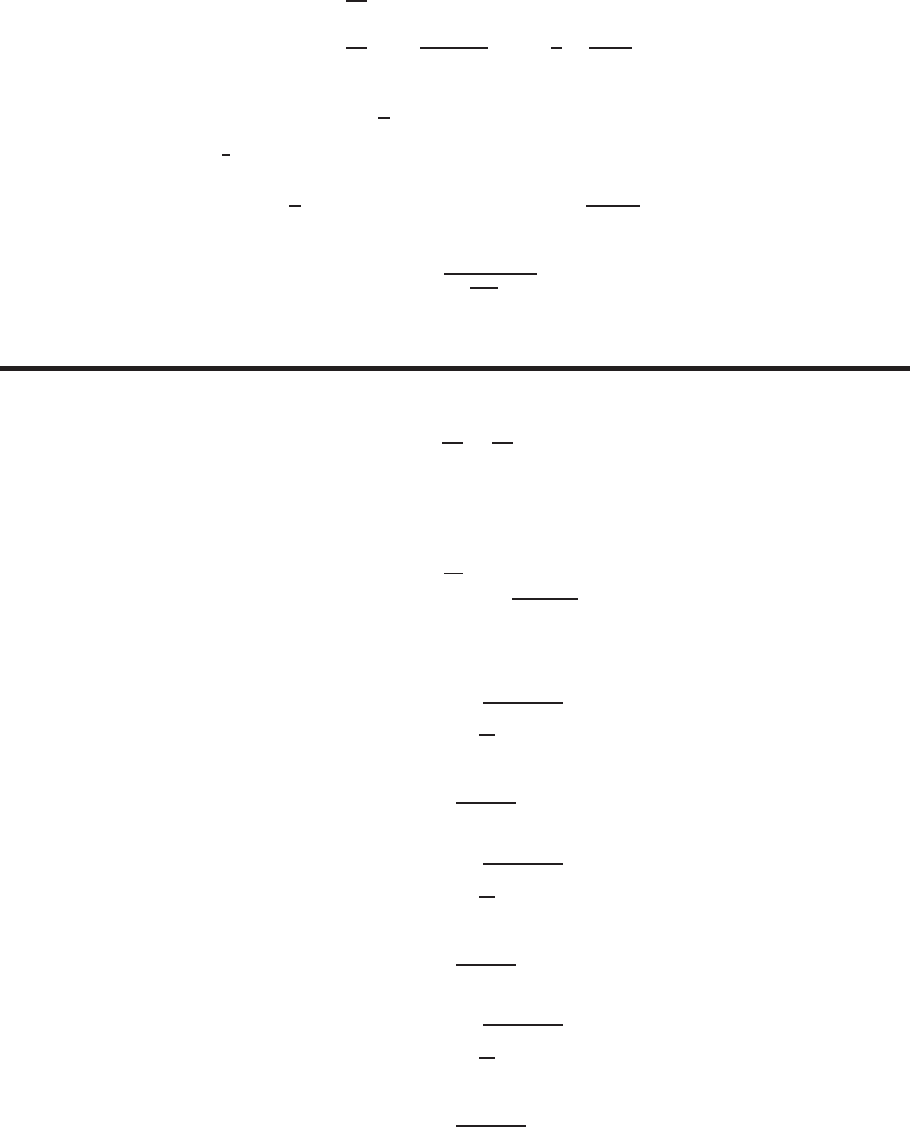
1046 Chapter Eleven /SOLUTIONS
28. Separating variables gives
x(x+ 1) du
dx =u2
Zdu
u2=Zdx
x(x+ 1) =Z1
x−1
1 + xdx,
so
−1
u= ln |x| − ln |x+ 1|+C.
We have u(1) = 1,so −1
1= ln |1| − ln |1 + 1|+C. So C= ln 2 −1.Solving for uyields
−1
u= ln |x| − ln |x+ 1|+ ln 2 −1 = ln 2|x|
|x+ 1|−1,
so
u=−1
ln |2x
x+1 | − 1.
Problems
29. (a) We separate variables and integrate:
dy
dx =4x
y2
y2dy = 4x dx
Zy2dy =Z4x dx
y3
3= 2x2+C
y=3
p6x2+B.
Here, we use Bas the arbitrary constant, replacing 3Cwhen we multiply through by 3.
(b) When we substitute y= 1 when x= 0, we have:
1 = 3
p6(02) + B
1 = 3
√B
B= 13= 1.
The particular solution satisfying y(0) = 1 is y=3
√6x2+ 1.
When we substitute y= 2 when x= 0, we have:
2 = 3
p6(02) + B
2 = 3
√B
B= 23= 8.
The particular solution satisfying y(0) = 2 is y=3
√6x2+ 8.
When we substitute y= 3 when x= 0, we have:
3 = 3
p6(02) + B
3 = 3
√B
B= 33= 27.
The particular solution satisfying y(0) = 3 is y=3
√6x2+ 27.
The three solutions are shown in Figure 11.24.

11.4 SOLUTIONS 1047
−4 4
4
x
y
Figure 11.24
30. (a) We separate variables and integrate:
dP
dt = 0.2(P−50)
1
P−50 dP = 0.2dt
Z1
P−50 dP =Z0.2dt
ln |P−50|= 0.2t+C
|P−50|=e0.2t+C
P−50 = Be0.2t
P= 50 + Be0.2t.
Here, we use Bas the arbitrary constant,replacing ±eC.
(b) When we substitute P= 40 when t= 0, we have:
40 = 50 + Be0.2(0)
40 = 50 + B
B=−10.
The particular solution satisfying P(0) = 40 is P= 50 −10e0.2t.
When we substitute P= 50 when t= 0, we have:
50 = 50 + Be0.2(0)
50 = 50 + B
B= 0.
The particular solution satisfying P(0) = 50 is the constant solution P= 50.
When we substitute P= 60 when t= 0, we have:
60 = 50 + Be0.2(0)
60 = 50 + B
B= 10.
The particular solution satisfying P(0) = 60 is P= 50 + 10e0.2t.
The three solutions are shown in Figure 11.25.
4
30
70
t
P
Figure 11.25

1048 Chapter Eleven /SOLUTIONS
31. (a) Separating variables and integrating gives
Z1
100 −ydy =Zdt
so that
−ln |100 −y|=t+C
or
y(t) = 100 −Ae−t.
(b) See Figure 11.26.
t
y
110
25
Figure 11.26
(c) The initial condition y(0) = 25 gives A= 75, so the solution is
y(t) = 100 −75e−t.
The initial condition y(0) = 110 gives A=−10 so the solution is
y(t) = 100 + 10e−t.
(d) The increasing function, y(t) = 100 −75e−t.
32. By separating variables, we obtain r dr =k dt. Integrating yields
r2
2=kt +C,
where Cis a constant. If t= 0 is the time when the spill begins, then r= 0 when t= 0; therefore, we must have C= 0.
Therefore, we have
r=√2kt.
Using the fact that r= 400 when t= 16, we obtain 400 = √2k·16; this yields k= 5000. Since the units of dr/dt are
feet/hour and ris measured in feet, the units of kmust be feet2/hour.
33. (a) See Figure 11.27.
(0,1)
(0,0)
(0,−1)
x
y
Figure 11.27

11.4 SOLUTIONS 1049
(b) It appears that the solution curves in the upper half plane are asymptotic to y= 0 as xtends to −∞, and that they
are unbounded above as xincreases.
It appears that the solution curves in the lower half plane are asymptotic to y= 0 as xtends to +∞, and that
they are unbounded below as xdecreases.
The solution curve through the origin is the x-axis, so it is asymptotic to y= 0 on both ends.
(c) We separate variables. From dy/dx =y2we get, for y6= 0,
Z1
y2dy =Zdx
−1
y=x+C
y=−1
x+C.
(d) For a given number C, the y-value is not defined for x=−C, so the formula gives two solution curves. The first is
y=−1
x+Cfor x < −C.
This curve is in the upper half plane, has a vertical asymptote at x=−Cand satisfies limx→−∞ y= 0. The second
curve is
y=−1
x+Cfor x > −C,
which is in the lower half plane, has a vertical asymptote at x=−C, and satisfies limx→+∞y= 0.
34. Separating variables gives ZdR
R=Zk dt.
Integrating gives
ln |R|=kt +C,
so
|R|=ekt+C=ekteC
R=Aekt,where A=±eCor A= 0.
35. Separating variables gives
dQ
dt =Q
k
ZdQ
Q=Z1
kdt
Integrating gives
ln |Q|=t
k+C
Q=Aet/k,where A=±eCor A= 0.
36. Separating variables gives ZdP
P−a=Zdt.
Integrating yields
ln |P−a|=t+C,
so
|P−a|=et+C=eteC
P=a+Aet,where A=±eCor A= 0.

1050 Chapter Eleven /SOLUTIONS
37. Separating variables gives ZdQ
b−Q=Zdt.
Integrating yields
−ln |b−Q|=t+C,
so
|b−Q|=e−(t+C)=e−te−C
Q=b−Ae−t,where A=±e−Cor A= 0.
38. Separating variables gives ZdP
P−a=Zk dt.
Integrating yields
ln |P−a|=kt +C,
so
P=a+Aekt where A=±eCor A= 0.
39. Factoring and separating variables gives
dR
dt =aR+b
a
ZdR
R+b/a =Za dt
ln R+b
a=at +C
R=−b
a+Aeat,where Acan be any constant.
40. Separating variables and integrating gives Z1
aP +bdP =Zdt.
This gives
1
aln |aP +b|=t+C
ln |aP +b|=at +aC
aP +b=±eat+aC =Aeat,where A=±eaC or A= 0,
or
P=1
a(Aeat −b).
41. Separating variables and integrating gives
Z1
y2dy =Zk(1 + t2)dt
or
−1
y=kt+1
3t3+C.
Hence,
y=−1
k(t+1
3t3) + C.

11.4 SOLUTIONS 1051
42. Separating variables and integrating gives Z1
R2+ 1 dR =Zadx
or
arctan R=ax +C
so that
R= tan(ax +C).
43. Separating variables and integrating gives
Z1
L−bdL =Zk(x+a)dx
or
ln |L−b|=k1
2x2+ax+C.
Solving for Lgives
L=b+Aek(1
2x2+ax),where Acan be any constant.
44. Separating variables gives
dy
dt =y(2 −y),
so Zdy
y(y−2) =−Zdt,
so
−1
2Z1
y−1
y−2dy =−Zdt.
Integrating yields 1
2(ln |y−2| − ln |y|) = −t+C,
so
ln |y−2|
|y|=−2t+ 2C.
Exponentiating both sides yields
1−2
y=e−2t+2C
2
y= 1 −Ae−2t,where A=±e2C
y=2
1−Ae−2t.
But
y(0) = 2
1−A= 1,
so A=−1, and
y=2
1 + e−2t.
45. Separating variables gives
dx
dt =xln x
t,
so Zdx
xln x=Zdt
t,
and thus
ln |ln x|= ln t+C,

1052 Chapter Eleven /SOLUTIONS
so
|ln x|=eCeln t=eCt.
Therefore
ln x=At, where A=±eCor A= 0,so x=eAt.
46. Separating variables gives
tdx
dt = (1 + 2 ln t) tan x
dx
tan x=1 + 2 ln t
tdt
Zcos x
sin xdx =Z1
t+2 ln t
tdt.
Integrating gives
ln |sin x|= ln t+ (ln t)2+C
|sin x|=eln t+(ln t)2+C=t(elnt)ln teC=t(tln t)eC.
So
sin x=At(ln t)+1,where A=±eCor A= 0.
Therefore
x= arcsin(At(ln t)+1).
47. Since dy
dt =−yln y
2,
we have dy
yln(y/2) =−dt,
so that Zdy
yln(y/2) =Z(−dt).
Substituting w= ln(y/2), dw =1
ydy gives:
Zdw
w=−Zdt
so
ln |w|=−t+C
ln ln y
2=−t+C.
Since y(0) = 1,we have C= ln |ln 1
2|= ln(| − ln 2|) = ln(ln 2).Thus
ln ln y
2=−t+ ln(ln 2),
or ln y
2=e−t+ln(ln 2)
Since eln(ln 2) = ln 2, this simplifies to ln y
2= (ln 2)e−t,
so
ln y
2=±(ln 2)e−t.

11.4 SOLUTIONS 1053
Since y(0) = 1, and ln(1/2) = −ln 2, we take the −sign, giving
ln y
2=−(ln 2)e−t.
Thus,
y= 2e−(ln 2)e−t
y=2(e−ln 2)e−t= 2(2−1)e−t
y= 2(2−e−t).
(Note that ln(y/2) = (ln 2)e−tdoes not satisfy y(0) = 1.)
48. (a) See Figure 11.28.
x
y
Figure 11.28
(b) It appears that the solution curves are unbounded below as xdecreases and unbounded above as xincreases.
(c) In the region −1≤y≤1, we have dy/dx = 1, a constant slope, so the solution curves in this region are straight
lines of slope 1: the equations are y=x+C. This formula holds for −C−1≤x≤ −C+ 1.
In the regions where |y| ≥ 1, we solve the differential equation by separation of variables,
Z1
y2dy =Zdx
−1
y=x+C
y=−1
x+C.
Thus, the formula for the general solution is y=−1/(x+C)for both y≤ −1and y≥1. The corresponding
x-values are determined as follows. We have y≤ −1if
−1
x+C≤ −1
1
x+C≥1
0< x +C≤1
−C < x ≤ −C+ 1.
We have y≥1if
−1
x+C≥1
1
x+C≤ −1
−1≤x+C < 0
−C−1≤x < −C.
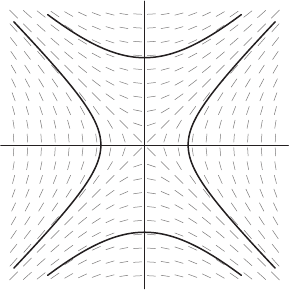
1054 Chapter Eleven /SOLUTIONS
Summarizing, with different constants for the three regions to avoid confusion, we have the following explicit
solutions:
If y≤ −1, then y=−1/(x+C1)for −C1< x ≤ −C1+ 1.
If −1≤y≤1, then y=x+C2for −C2−1≤x≤ −C2+ 1.
If 1≤y, then y=−1/(x+C3)for −C3−1≤x < −C3.
(d) If a solution curve touches the region y≤ −1, then the formula y=−1/(x+C1)found in part (c) shows that
x=−C1is a vertical asymptote. Moreover, the curve touches the line y=−1at x= 1 −C1. The curve continues,
crossing the region −1≤y≤1as a straight line of slope 1, until it reaches the horizontal line y= 1. After that the
solution curve enters the region y≥1where there is a vertical asymptote at x=−C3.
A similar argument applies if a solution curves touches the region y≥1.
Finally, if a solution curve touches the region −1≤y≤1then it has a straight line section that runs to the
two horizontal lines y=−1and y= 1 where the solution curve enters the two outer regions where |y| ≥ 1and
approaches vertical asymptotes.
(e) A complete solution curve has the formula
y=(−1/(x+C1)if−C1< x ≤ −C1+ 1
x+C2if −C2−1≤x≤ −C2+ 1
−1/(x+C3)if −C3−1≤x < −C3
where the conditions that the first two formulas match up where y=−1and the last two match up where y= 1 are
given by
−C1+ 1 = −C2−1
−C2+ 1 = −C3−1.
Thus C2=C1−2and C3=C2−2 = (C1−2) −2 = C1−4.
The two vertical asymptotes are thus
x=−C1
x=−C3=−C1+ 4.
The second asymptote is 4 units to the right of the first.
49. (a), (b) See Figure 11.29.
y
x
Figure 11.29
(c) Since dy/dx =x/y, we have Zy dy =Zx dx,
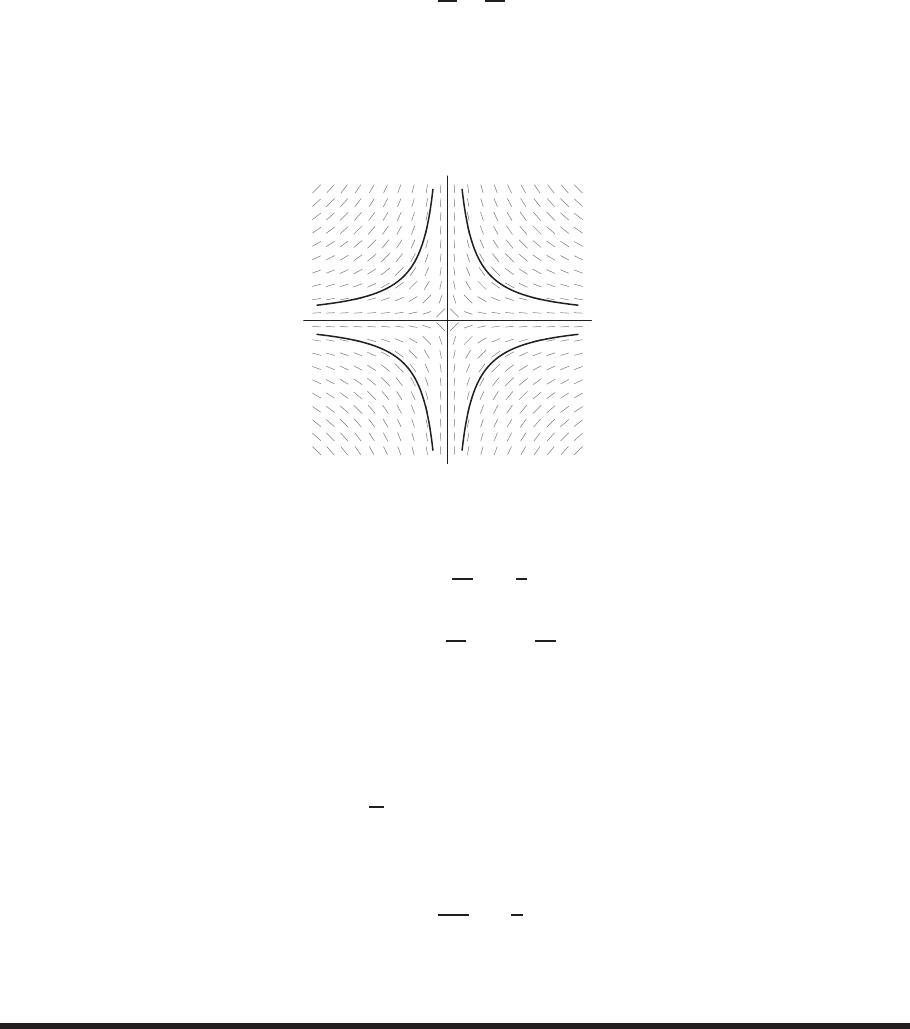
11.4 SOLUTIONS 1055
and thus
y2
2=x2
2+C,
or
y2−x2= 2C.
This is the equation of the hyperbolas in part (b).
50. (a), (b) See Figure 11.30.
x
y
Figure 11.30
(c) Since
dy
dx =−y
x,
we have Zdy
y=−Zdx
x,
so
ln |y|=−ln |x|+C,
giving
|y|=e−ln |x|+C= (|x|)−1eC.
Thus,
y=A
x,where A=±eCor A= 0.
51. By looking at the slope fields, we see that any solution curve of y′=x/y intersects any solution curve to y′=−y/x.
Now if the two curves intersect at (x, y),then the two slopes at (x, y)are negative reciprocals of each other, because
−1
x/y =−y
x.
Hence, the two curves intersect at right angles.
Strengthen Your Understanding
52. It is impossible to separate variables in the differential equation dy/dx =x+y. If we subtract yfrom both sides, we
obtain dy/dx −y=x. If we then try to separate the dx, we have dy −y dx =x dx. The variables cannot be separated
in this differential equation.
53. The solution to dP/dt = 0.2tis P= 0.1t2+C.
Exponential growth occurs when the derivative is a constant multiple of the dependent variable, not the independent
variable.
54. We have dy/dx =ex+y=exey. Dividing both sides by ey, we have e−ydy/dx =ex. Then multiplying both sides by
dx, we have e−ydy =exdx. Since e−yis certainly not equal to −ey, the statement is false.
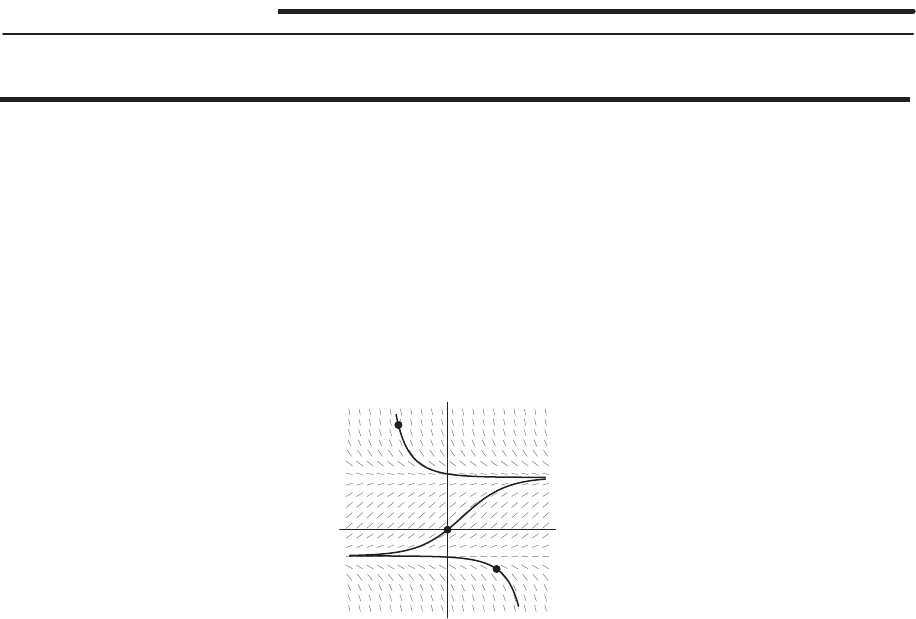
1056 Chapter Eleven /SOLUTIONS
55. There are many differential equations which are not separable. One possible example is dy/dx =x+y. Other examples
are possible.
56. An expression such as f(x) = cos xsatisfies the requirement since dy/dx = cos x+xy −cos x=xy is a separable
differential equation. Other examples are possible.
57. This family has f′(x) = 2x, so let dy/dx = 2x.
58. If we differentiate implicitly the equation for the family, we get 2x−2ydy/dx = 0. Solving for dy/dx, we get the
differential equation we want: dy/dx =x/y.
59. True. The general solution to y′=−ky is y=Ce−kt.
60. False. In order to be solved using separation of variables, a differential equation must have the form dy/dx =f(x)g(y),
so we would need x+y=f(x)g(y). This certainly does not appear to be true. If it were, setting x= 0 and y= 0, we
would have f(0)g(0) = 0 so either f(0) = 0 or g(0) = 0. If f(0) = 0, then substituting in x= 0 and y= 1, we have
0 + 1 = f(0)g(1) = 0, which is absurd. We get the same contradiction if we assume g(0) = 0.
61. True. Rewrite the equation as dy/dx =xy +x=x(y+ 1). Since the equation now has the form dy/dx =f(x)g(y), it
can be solved by separation of variables.
62. False. It is true that y=x3is a solution of the differential equation, since dy/dx = 3x2= 3y2/3, but it is not the only
solution passing through (0,0). Another solution is the constant function y= 0. Usually there is only one solution curve
to a differential equation passing through a given point, but not always.
Solutions for Section 11.5
Exercises
1. (a) = (III), (b) = (IV), (c) = (I), (d) = (II).
2. (a) (I)
(b) (IV)
(c) (II) and (IV)
(d) (II) and (III)
3. (a) The equilibrium solutions occur where the slope y′= 0, which occurs on the slope field where the lines are horizontal,
or (looking at the equation) at y= 2 and y=−1. Looking at the slope field, we can see that y= 2 is stable, since
the slopes at nearby values of ypoint toward it, whereas y=−1is unstable.
(b) Draw solution curves passing through the given points by starting at these points and following the flow of the slopes,
as shown in Figure 11.31.
x
y
Figure 11.31
4. The equilibrium solutions of a differential equation are those functions satisfying the differential equation whose derivative
is everywhere 0. Graphically, this means that a function is an equilibrium solution if it is a horizontal line that lies on the
slope field. Looking at the figure in the problem, it appears that the equilibrium solutions for this problem are at y= 1
and y= 3. An equilibrium solution is stable if a small change in the initial value conditions gives a solution which

11.5 SOLUTIONS 1057
tends toward equilibrium as t→ ∞. We see that y= 3 is a stable solution, while y= 1 is an unstable solution. See
Figure 11.32.
−5 5
−5
5
t
y
Figure 11.32
5. For y=α, we have dy/dt = 0, so the solution curve is horizontal. This is an equilibrium solution.
For y > α, we have dy/dt < 0, so the function is decreasing.
For y < α, we have dy/dt > 0, so the function is increasing. See Figure 11.33.
α
t
y
Figure 11.33
6. When the derivative dw/dt = 0, the function is constant. This occurs when w= 3 or w= 7. So, w= 3 and w= 7
are solutions. Their graphs are horizontal lines. When 3< w < 7, the derivative is negative. Therefore, solutions, w,
are decreasing in this region. For w < 3or w > 7, the derivative is positive. Thus, solutions, w, are increasing in these
regions. See Figure 11.34.
1
3
6
7
t
w
Figure 11.34
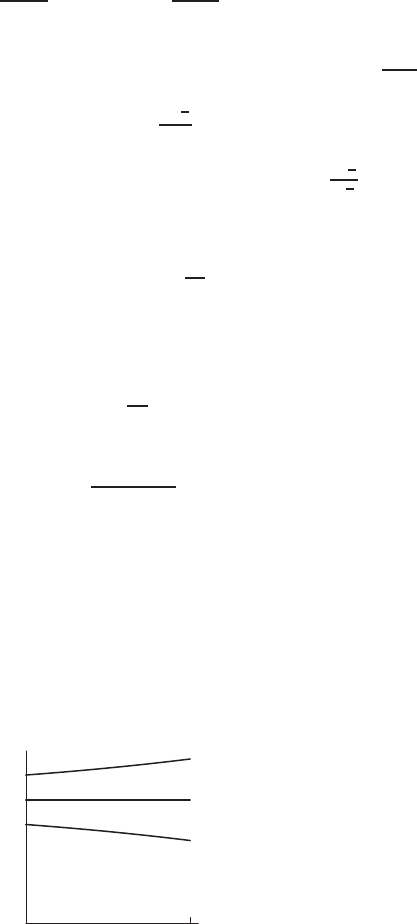
1058 Chapter Eleven /SOLUTIONS
7. (a) Separating variables, we have dH
H−200 =−k dt, so RdH
H−200 =R−k dt, whence ln |H−200|=−kt +C, and
H−200 = Ae−kt,where A=±eC.The initial condition is that the yam is 20◦Cat the time t= 0.Thus
20 −200 = A, so A=−180.Thus H= 200 −180e−kt .
(b) Using part (a), we have 120 = 200 −180e−k(30).Solving for k, we have e−30k=−80
−180 , giving
k=ln 4
9
−30 ≈0.027.
Note that this kis correct if tis given in minutes. (If tis given in hours, k=ln 4
9
−1
2≈1.62.)
8. (a) We know that the equilibrium solution is the solution satisfying the differential equation whose derivative is every-
where 0. Thus we have
dy
dt = 0
0.5y−250 = 0
y= 500.
(b) We use separation of variables. Since
dy
dt = 0.5y−250,
we have
Z1
0.5y−250 dy =Zdt
2 ln |0.5y−250|=t+C
0.5y−250 = e(t+C)/2
y=Aet/2+ 500,
where A= 2eC/2.
(c) Using initial value y(0) = 500, we have y= 500, the equilibrium solution. Using initial value y(0) = 400, we have
A=−100 and so y= 500−100et/2. Using initial value y(0) = 600, we have A= 100 and so y= 500+ 100et/2.
These three solutions are shown below.
1
500
y= 500 + 100et/2
y=500
y= 500 −100et/2
t
y
(d) We see above that the equilibrium solution y=500 is unstable.
9. (a) To find the equilibrium solutions, we must set
dy/dx = 0.5y(y−4)(2 + y) = 0
which gives three solutions: y= 0,y= 4, and y=−2.
(b) From Figure 11.35, we see that y= 0 is stable and y= 4 and y=−2are both unstable.

11.5 SOLUTIONS 1059
x
y
Figure 11.35
10. (a) A very hot cup of coffee cools faster than one near room temperature. The differential equation given says that the
rate at which the coffee cools is proportional to the difference between the temperature of the surrounding air and the
temperature of the coffee. Since dH/dt < 0(the coffee is cooling) and H−20 >0(the coffee is warmer than room
temperature), kmust be positive.
(b) Separating variables gives Z1
H−20 dH =Z−kdt
and so
ln |H−20|=−kt +C
and
H(t) = 20 + Ae−kt.
If the coffee is initially boiling (100◦C), then A= 80 and so
H(t) = 20 + 80e−kt.
When t= 2, the coffee is at 90◦Cand so 90 = 20 + 80e−2kso that k=1
2ln 8
7.
Let the time when the coffee reaches 60◦Cbe Hd, so that
60 = 20 + 80e−kHd
e−kHd=1
2.
Therefore,
Hd=1
kln 2 = 2 ln 2
ln 8
7≈10minutes.
11. Since it takes 6 years to reduce the pollution to 10%, another 6 years would reduce the pollution to 10% of 10%, which is
equivalent to 1% of the original. Therefore it takes 12 years for 99% of the pollution to be removed. (Note that the value
of Q0does not affect this.) Thus the second time is double the first because the fraction remaining, 0.01, in the second
instance is the square of the fraction remaining, 0.1, in the first instance.
12. Michigan:
dQ
dt =−r
VQ=−158
4.9×103Q≈ −0.032Q
so
Q=Q0e−0.032t.
We want to find tsuch that
0.1Q0=Q0e−0.032t
so
t=−ln(0.1)
0.032 ≈72 years.
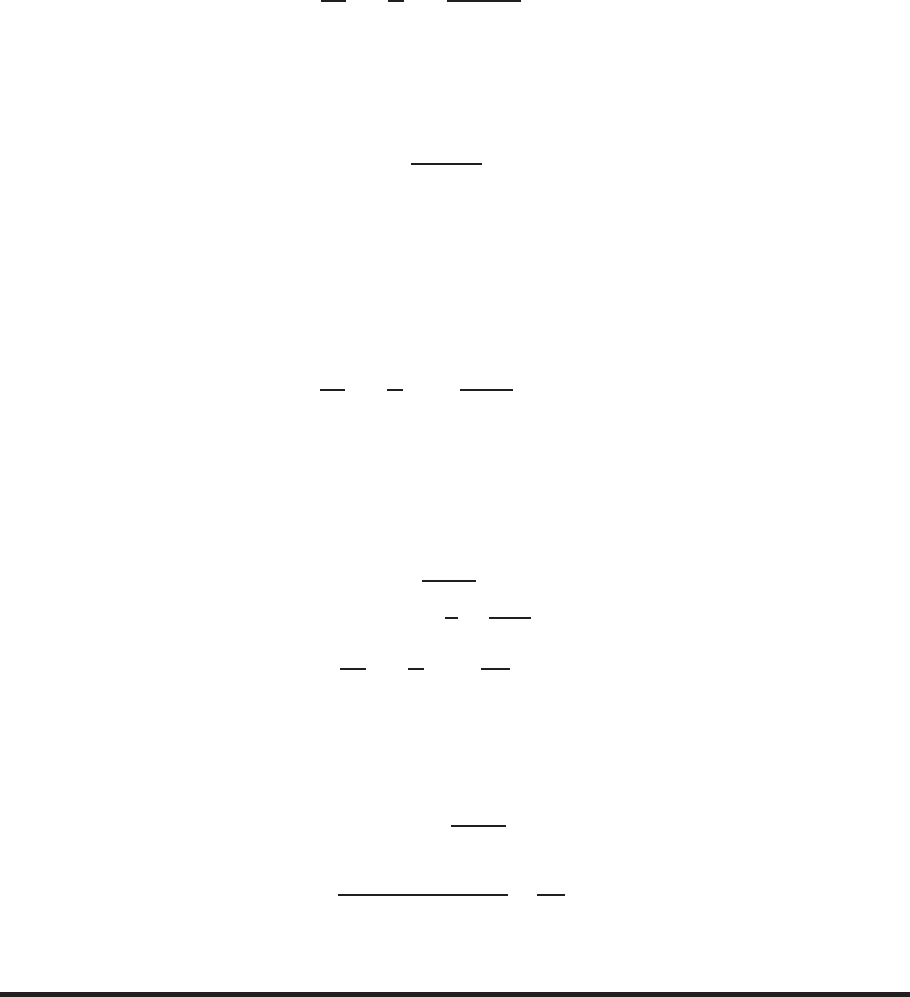
1060 Chapter Eleven /SOLUTIONS
Ontario: dQ
dt =−r
VQ=−209
1.6×103Q=−0.131Q
so
Q=Q0e−0.131t.
We want to find tsuch that
0.1Q0=Q0e−0.131t
so
t=−ln(0.1)
0.131 ≈18 years.
Lake Michigan will take longer because it is larger (4900 km3compared to 1600 km3) and water is flowing through
it at a slower rate (158 km3/year compared to 209 km3/year).
13. Lake Superior will take the longest, because the lake is largest (Vis largest) and water is moving through it most slowly
(ris smallest). Lake Erie looks as though it will take the least time because Vis smallest and ris close to the largest. For
Erie, k=r/V = 175/460 ≈0.38. The lake with the largest value of ris Ontario, where k=r/V = 209/1600 ≈0.13.
Since e−kt decreases faster for larger k, Lake Erie will take the shortest time for any fixed fraction of the pollution to be
removed.
For Lake Superior,
dQ
dt =−r
VQ=−65.2
12,200 Q≈ −0.0053Q
so
Q=Q0e−0.0053t.
When 80% of the pollution has been removed, 20% remains so Q= 0.2Q0. Substituting gives us
0.2Q0=Q0e−0.0053t
so
t=−ln(0.2)
0.0053 ≈301 years.
(Note: The 301 is obtained by using the exact value of r
V=65.2
12,200 , rather than 0.0053. Using 0.0053 gives 304 years.)
For Lake Erie, as in the text dQ
dt =−r
VQ=−175
460 Q≈ −0.38Q
so
Q=Q0e−0.38t.
When 80% of the pollution has been removed
0.2Q0=Q0e−0.38t
t=−ln(0.2)
0.38 ≈4years.
So the ratio is Time for Lake Superior
Time for Lake Erie ≈301
4≈75.
In other words it will take about 75 times as long to clean Lake Superior as Lake Erie.
Problems
14. (a) We define Pto be the population of India, in billions of people, in year t, where trepresents the number of years
since 2010.
(b) We have dP/dt = 0.0135Pwith initial condition P(0) = 1.15.
(c) The general solution is P=Ce0.0135tand the particular solution satisfying the initial condition is P= 1.15e0.0135t.
15. (a) We define Nto be the amount of nicotine in the body, in mg, at time t, where trepresents the number of hours since
smoking the cigarette.
(b) We have dN/dt =−0.347Nwith initial condition N(0) = 0.4. Notice that the constant −0.347 is negative since
the quantity of nicotine is decreasing.
(c) The general solution is N=Ce−0.347tand the particular solution satisfying the initial condition is N= 0.4e−0.347t.
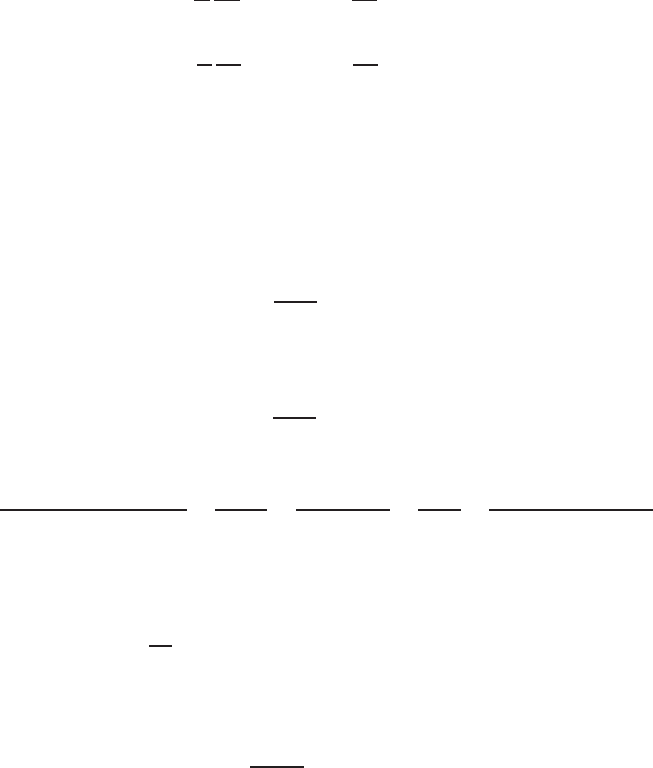
11.5 SOLUTIONS 1061
16. (a) We define Sto be world solar PV market installations, in megawatts, in year t, where trepresents the number of
years since 2007.
(b) We have dS/dt = 0.48Swith initial condition S(0) = 2826.
(c) The general solution is S=Ce0.48tand the particular solution satisfying the initial condition is S= 2826e0.48t.
17. (a) We define Gto be the size, in acres, of Grinnell Glacier in year t, where trepresents the number of years since 2007.
(b) We have dG/dt =−0.043Gwith initial condition G(0) = 142. Notice that the constant −0.043 is negative because
the size is decreasing.
(c) The general solution is G=Ce−0.043tand the particular solution satisfying the initial condition is G= 142e−0.043t.
18. (a) The differential equation is
1
B
dB
dt = 0.067 or dB
dt = 0.067B.
(b) The differential equation is
1
P
dP
dt = 0.033 or dP
dt = 0.033P.
(c) For initial prices B0and P0, solving the differential equations in part (a) and part (b) gives
B=B0e0.067t,
and
P=P0e0.033t.
(d) Doubling time for textbook price is given by
2B0=B0e0.067t
t=ln 2
0.067 = 10.345 years.
(e) Doubling time for inflation is given by
2P0=P0e0.033t
t=ln 2
0.033 = 21.004 years.
(f) The doubling times are in the ratio
Doubling time:Textbook
Doubling time:Inflation =10.345
21.004 =(ln 2)/0.067
(ln 2)/0.033 =0.033
0.067 =Inflation growth rate
Textbook growth rate .
The ratio of the doubling times is the reciprocal of the ratio of the growth rates.
19. We find the temperature of the orange juice as a function of time. Newton’s Law of Heating says that the rate of change of
the temperature is proportional to the temperature difference. If Sis the temperature of the juice, this gives us the equation
dS
dt =−k(S−65) for some constant k.
Notice that the temperature of the juice is increasing, so the quantity dS/dt is positive. In addition, S= 40 initially,
making the quantity (S−65) negative.
Separating variables gives: ZdS
S−65 =−Zk dt
ln |S−65|=−kt +C
S−65 = Ae−kt ,where A=±eC.
So
S= 65 + Ae−kt.
Since at t= 0,S= 40, we have 40 = 65 + C, so C=−25. Thus, S= 65 −25e−kt for some positive constant k. See
Figure 11.36 for the graph.
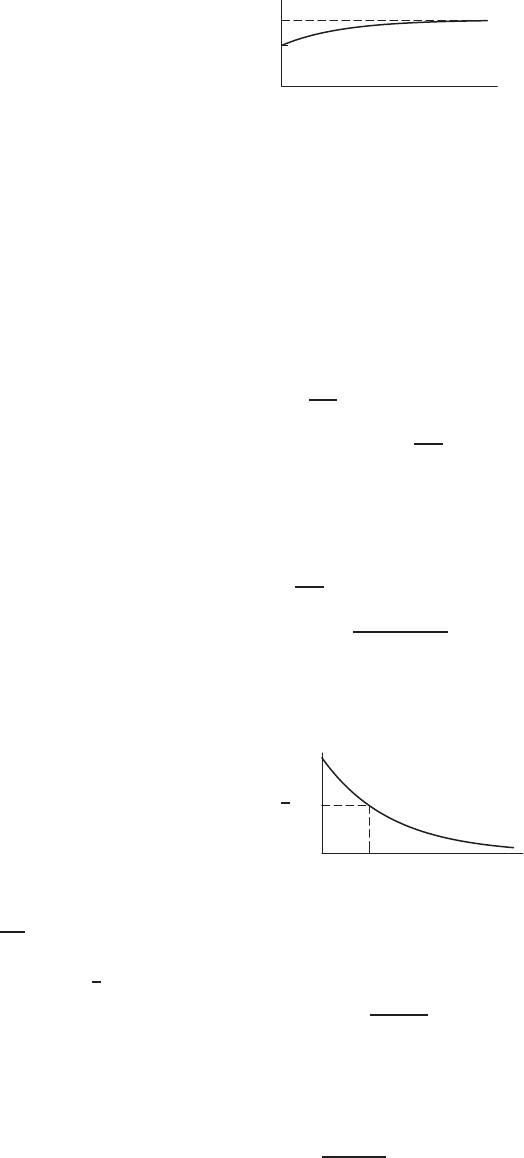
1062 Chapter Eleven /SOLUTIONS
40◦
65◦
t
S
(
◦
F)
Figure 11.36
: Graph of
S= 65 −25e−kt for k > 0
20. According to Newton’s Law of Cooling, the temperature, T, of the roast as a function of time, t, satisfies
T′(t) = k(350 −T)
T(0) = 40.
Solving this differential equation, we get that T= 350 −310e−kt for some k > 0. To find k, we note that at t= 1 we
have T= 90, so
90 = 350 −310e−k(1)
260
310 =e−k
k=−ln 260
310
≈0.17589.
Thus, T= 350 −310e−0.17589t. Solving for twhen T= 140, we have
140 = 350 −310e−0.17589t
210
310 =e−0.17589t
t=ln(210/310)
−0.17589
t≈2.21 hours.
21. (a)
37
1
2Q0
Q0
t
Q
Q=Q0e−0.0187t
(b) dQ
dt =−kQ
(c) Since 25% = 1/4, it takes two half-lives = 74 hours for the drug level to be reduced to 25%. Alternatively, Q=
Q0e−kt and 1
2=e−k(37), we have
k=−ln(1/2)
37 ≈0.0187.
Therefore Q=Q0e−0.0187t. We know that when the drug level is 25% of the original level that Q= 0.25Q0.
Setting these equal, we get
0.25 = e−0.0187t.
giving
t=−ln(0.25)
0.0187 ≈74 hours ≈3 days.
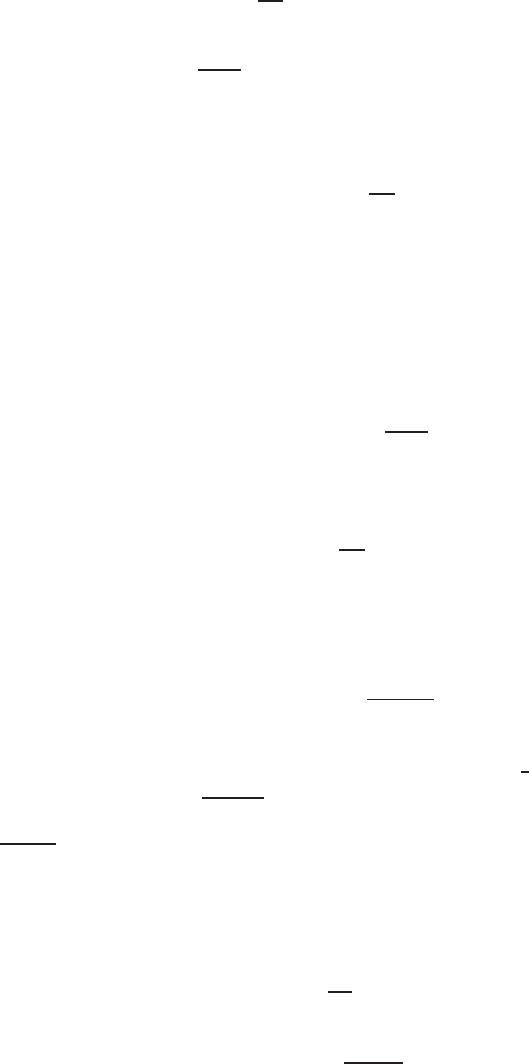
11.5 SOLUTIONS 1063
22. (a) Since the amount leaving the blood is proportional to the quantity in the blood,
dQ
dt =−kQ for some positive constant k.
Thus Q=Q0e−kt, where Q0is the initial quantity in the bloodstream. Only 20% is left in the blood after 3 hours.
Thus 0.20 = e−3k, so k=ln 0.20
−3≈0.5365. Therefore Q=Q0e−0.5365t.
(b) Since 20% is left after 3 hours, after 6 hours only 20% of that 20% will be left. Thus after 6 hours only 4% will be
left, so if the patient is given 100 mg, only 4 mg will be left 6 hours later.
23. (a) Suppose Y(t)is the quantity of oil in the well at time t. We know that the oil in the well decreases at a rate proportional
to Y(t), so
dY
dt =−kY.
Integrating, and using the fact that initially Y=Y0= 106, we have
Y=Y0e−kt = 106e−kt.
In six years, Y= 500,000 = 5 ·105, so
5·105= 106e−k·6
so
0.5 = e−6k
k=−ln 0.5
6= 0.1155.
When Y= 600,000 = 6 ·105,
Rate at which oil decreasing =
dY
dt =kY= 0.1155(6 ·105) = 69,300 barrels/year.
(b) We solve the equation
5·104= 106e−0.1155t
0.05 = e−0.1155t
t=ln 0.05
−0.1155 = 25.9years.
24. (a) If C′=−kC, and then C=C0e−kt.Since the half-life is 5730 years, 1
2C0=C0e−5730k.Solving for k, we have
−5730k= ln(1/2) so k=−ln(1/2)
5730 ≈0.000121.
(b) From the given information, we have 0.91 = e−kt,where tis the age of the shroud. Solving for t, we have t=
−ln 0.91
k≈779.4years.
25. The rate of disintegration is proportional to the quantity of carbon-14 present. Let Qbe the quantity of carbon-14 present
at time t, with t= 0 in 1977. Then
Q=Q0e−kt,
where Q0is the quantity of carbon-14 present in 1977 when t= 0. Then we know that
Q0
2=Q0e−k(5730)
so that
k=−ln(1/2)
5730 = 0.000121.
Thus
Q=Q0e−0.000121t.
The quantity present at any time is proportional to the rate of disintegration at that time so
Q0=c8.2and Q=c13.5
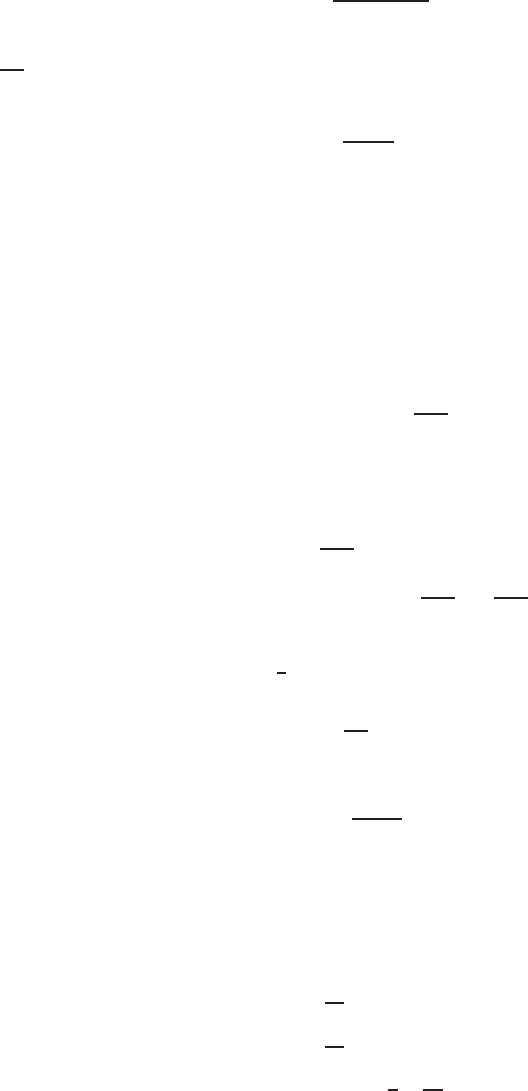
1064 Chapter Eleven /SOLUTIONS
where cis a constant of proportionality. Thus substituting for Qand Q0in
Q=Q0e−0.000121t
gives
c13.5 = c8.2e−0.000121t
so
t=−ln(13.5/8.2)
0.000121 ≈ −4120.
Thus Stonehenge was built about 4120 years before 1977, in about 2150 B.C.
26. (a) dT
dt =−k(T−A), where A= 68◦F is the temperature of the room, and tis time since 9 am.
(b)
ZdT
T−A=−Zkdt
ln |T−A|=−kt +C
T=A+Be−kt.
Using A= 68, and T(0) = 90.3, we get B= 22.3. Thus
T= 68 + 22.3e−kt .
At t= 1, we have
89.0 = 68 + 22.3e−k
21 = 22.3e−k
k=−ln 21
22.3≈0.06.
Thus T= 68 + 22.3e−0.06t.
We want to know when Twas equal to 98.6◦F, the temperature of a live body, so
98.6 = 68 + 22.3e−0.06t
ln 30.6
22.3=−0.06t
t=−1
0.06 ln 30.6
22.3
t≈ −5.27.
The victim was killed approximately 51
4hours prior to 9 am, at 3:45 am.
27. (a) The differential equation is
dT
dt =−k(T−A),
where A= 10◦F is the outside temperature.
(b) Integrating both sides yields ZdT
T−A=−Zk dt.
Then ln |T−A|=−kt +C, so T=A+Be−kt. Thus
T= 10 + 58e−kt.
Since 10:00 pm corresponds to t= 9,
57 = 10 + 58e−9k
47
58 =e−9k
ln 47
58 =−9k
k=−1
9ln 47
58 ≈0.0234.

11.5 SOLUTIONS 1065
At 7:00 the next morning (t= 18) we have
T≈10 + 58e18(−0.0234)
= 10 + 58(0.66)
≈48◦F,
so the pipes won’t freeze.
(c) We assumed that the temperature outside the house stayed constant at 10◦F. This is probably incorrect because the
temperature was most likely warmer during the day (between 1 pm and 10 pm) and colder after (between 10 pm and
7 am). Thus, when the temperature in the house dropped from 68◦F to 57◦F between 1 pm and 10 pm, the outside
temperature was probably higher than 10◦F, which changes our calculation of the value of the constant k. The house
temperature will most certainly be lower than 48◦F at 7 am, but not by much—not enough to freeze.
28. (a) Since speed is the derivative of distance, Galileo’s mistaken conjecture was dD
dt =kD.
(b) We know that if Galileo’s conjecture were true, then D(t) = D0ekt, where D0would be the initial distance fallen.
But if we drop an object, it starts out not having traveled any distance, so D0= 0. This would lead to D(t) = 0 for
all t.
29. (a) Letting kbe the constant of proportionality, by Newton’s Law of Cooling, we have
dH
dt =k(68 −H).
(b) To find the equilibrium solution, we solve dH/dt =k(68 −H) = 0. We find that H= 68 is an equilibrium
solution. This makes sense because the temperature of an object at 68◦F in a 68◦F room will not change. To determine
whether the equilibrium is stable, we consider a solution with an initial condition near H= 68. If H= 69, then
dH/dt =k(68 −69) = −k, which is negative; therefore, Hwill decrease and move towards the equilibrium.
Similarly, a solution with an initial condition less than H= 68 will increase towards the equilibrium. Therefore, the
equilibrium is stable.
(c) We solve this equation by separating variables:
ZdH
68 −H=Zk dt
−ln |68 −H|=kt +C
68 −H=±eC−kt
H= 68 −Ae−kt.
(d) We are told that H= 40 when t= 0; this tells us that
40 = 68 −Ae−k(0)
40 = 68 −A
A= 28.
Knowing A, we can solve for kusing the fact that H= 48 when t= 1:
48 = 68 −28e−k(1)
20
28 =e−k
k=−ln 20
28 = 0.33647.
So the formula is H(t) = 68 −28e−0.33647t. We calculate Hwhen t= 3, by
H(3) = 68 −28e−0.33647(3) = 57.8◦F.
30. (a) Since we are told that the rate at which the quantity of the drug decreases is proportional to the amount of the drug
left in the body, we know the differential equation modeling this situation is
dQ
dt =kQ.
Since we are told that the quantity of the drug is decreasing, we know that k < 0.

1066 Chapter Eleven /SOLUTIONS
(b) To find the equilibrium, we solve dQ/dt = 0 and get Q= 0. Thus, Q= 0 is an equilibrium. This makes sense
because patients with no hydrocodone bitartrate in their body will remain that way unless they take the drug. We
expect the equilibrium to be stable because patients who have taken the drug will gradually lose it, moving towards
the equilibrium. We can confirm this by checking solutions with initial conditions near Q= 0.
(c) We know that the general solution to the differential equation
dQ
dt =kQ
is
Q=Cekt.
(d) We are told that the half life of the drug is 3.8hours. This means that at t= 3.8, the amount of the drug in the body
is half the amount that was in the body at t= 0, or, in other words,
0.5Q(0) = Q(3.8).
Solving this equation gives
0.5Q(0) = Q(3.8)
0.5Cek(0) =Cek(3.8)
0.5C=Cek(3.8)
0.5 = ek(3.8)
ln(0.5) = k(3.8)
ln(0.5)
3.8=k
k≈ −0.182.
(e) From part (c) we know that the formula for Qis
Q=Ce−0.182t.
We are told that initially there are 10 mg of the drug in the body. Thus, at t= 0, we get
10 = Ce−0.182(0)
so
C= 10.
Thus, our equation becomes
Q(t) = 10e−0.182t.
Substituting t= 12, we get
Q(t) = 10e−0.182t
Q(12) = 10e−0.182(12)
= 10e−2.184
Q(12) ≈1.126 mg.
31. (a) The differential equation is
dB
dt =r
100 ·B.
The constant of proportionality is r
100 .
(b) To find the equilibrium, we solve
dB
dt =r
100 ·B= 0
to get B= 0.
If we have a solution with initial condition B > 0, then dB/dt > 0, and the solution increases and moves away
from the equilibrium. Thus, the equilibrium is unstable. In terms of a bank account, this means that an empty bank
account remains empty unless somebody deposits money into it, but a bank account with money in it accumulates
more money.
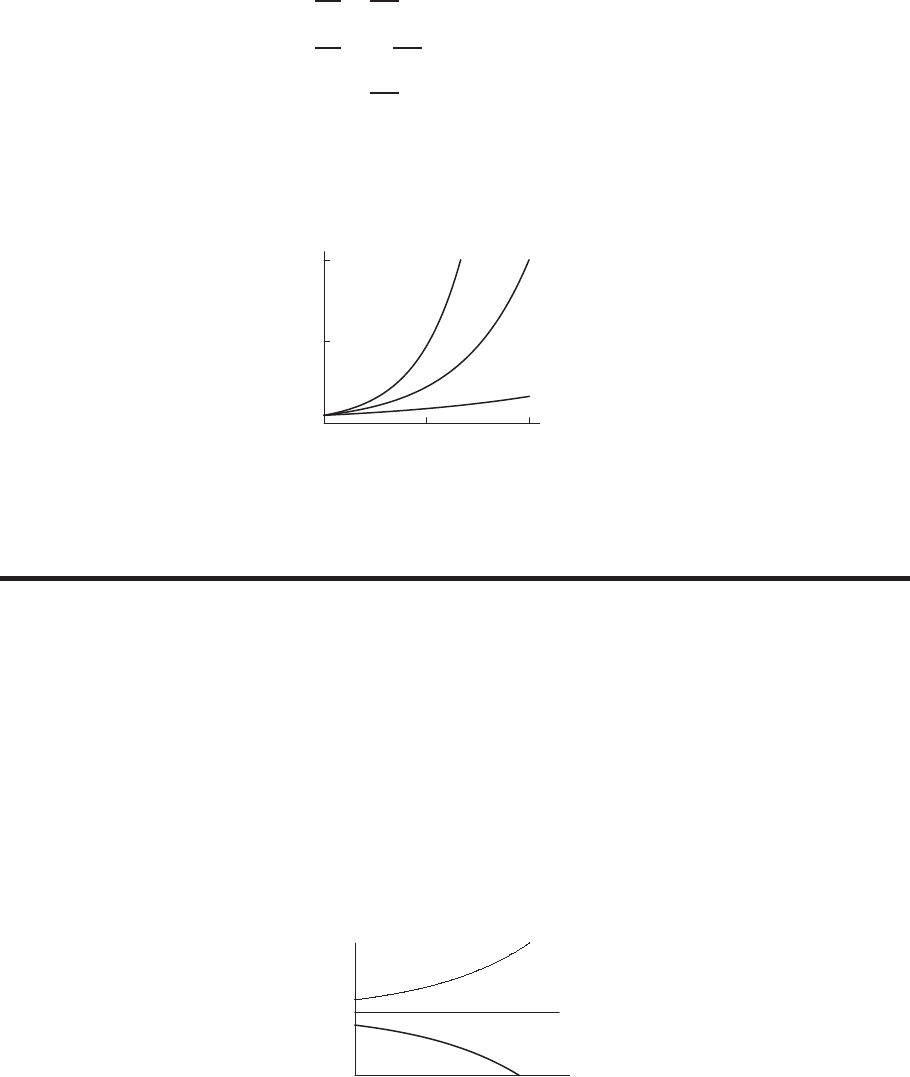
11.5 SOLUTIONS 1067
(c) Solving, we have
dB
B=r dt
100
ZdB
B=Zr
100 dt
ln |B|=r
100 t+C
B=±e(r/100)t+C=Ae(r/100)t, A =±eC.
Ais the initial amount in the account, since Ais the amount at time t= 0.
(d) See Figure 11.37.
15 30
1000
10,000
20,000
t
B= 1000e0.10t
B=1000e0.04t
B=1000e0.15t
Figure 11.37
Strengthen Your Understanding
32. When y= 2, we have dy/dx = 8 −8x6= 0. An equilibrium solution must have derivative equal to zero for all values of
x.
33. An equilibrium is a constant solution, so y=x2cannot be an equilibrium solution.
34. Newton’s Law of Heating and Cooling says that the rate of change of the temperature of an object is proportional to the
difference between the temperature of the object and the temperature of the surrounding air. Once the roast is in the oven,
the temperature of the surrounding air is 350◦F, so the correct differential equation is dH/dt =k(H−350).
35. The differential equation is of the form dy/dt =ky, where kis negative. One possible answer is dy/dt =−2y.
36. Some possible answers are dQ/dt =Q−500 or dQ/dx = 2(Q−500). Other answers are possible. We must have Q
as the dependent variable and the derivative equal to zero when Q= 500.
37. Since the graph has an equilibrium solution at P= 25, the solution with initial condition P0= 25 must be a horizontal
line. Since the equilibrium solution is unstable, it is likely that the solutions with P0= 20 and P0= 30 bend away from
the horizontal line. See Figure 11.38. Other answers are possible.
25
t
P
Figure 11.38
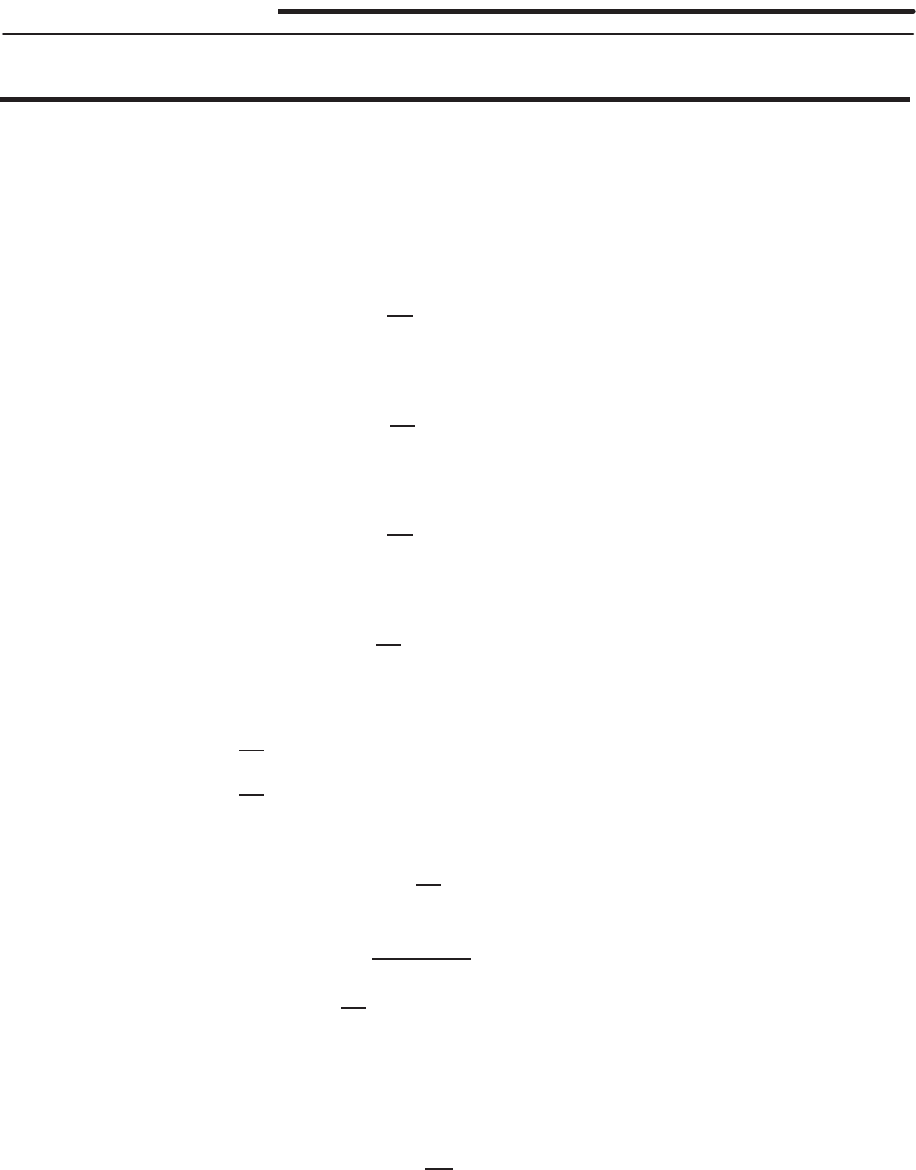
1068 Chapter Eleven /SOLUTIONS
Solutions for Section 11.6
Exercises
1. (a) (III) An island can only sustain the population up to a certain size. The population will grow until it reaches this
limiting value.
(b) (V) The ingot will get hot and then cool off, so the temperature will increase and then decrease.
(c) (I) The speed of the car is constant, and then decreases linearly when the breaks are applied uniformly.
(d) (II) Carbon-14 decays exponentially.
(e) (IV) Tree pollen is seasonal, and therefore cyclical.
2. The balance is increasing at a rate of 0.05 times the current balance and is decreasing at a rate of 12,000 dollars per year.
The differential equation is
dB
dt = 0.05B−12,000.
3. The balance is increasing at a rate of 0.037 times the current balance and is also increasing at a rate of 5000 dollars per
year. The differential equation is
dB
dt = 0.037B+ 5000.
4. The balance is decreasing at a rate of 0.08 times the current balance and is increasing at a rate of 2000 dollars per year.
The differential equation is
dB
dt =−0.08B+ 2000.
5. The balance is decreasing at a rate of 0.065 times the current balance and is also decreasing at a rate of 50,000 dollars per
year. The differential equation is
dB
dt =−0.065B−50,000.
6. (a) If B=f(t), where tis in years,
dB
dt =Rate of money earned from interest +Rate of money deposited
dB
dt = 0.10B+ 1000.
(b) We use separation of variables to solve the differential equation
dB
dt = 0.1B+ 1000.
Z1
0.1B+ 1000 dB =Zdt
1
0.1ln |0.1B+ 1000|=t+C1
0.1B+ 1000 = C2e0.1t
B=Ce0.1t−10,000
For t= 0,B= 0, hence C= 10,000. Therefore, B= 10,000e0.1t−10,000.
7. (a) By Newton’s Law of Cooling, we have
dH
dt =k(H−50)
for some k. Furthermore, we know the juice’s original temperature H(0) = 90.
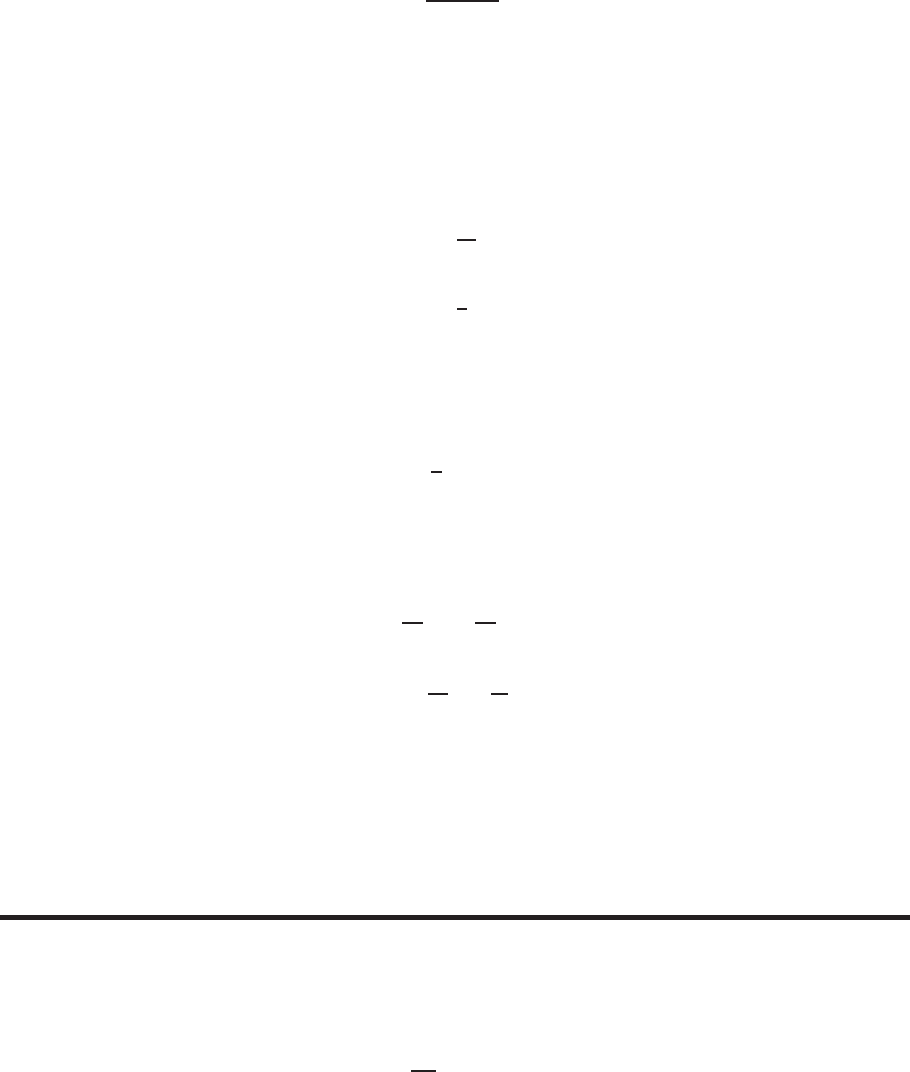
11.6 SOLUTIONS 1069
(b) Separating variables, we get ZdH
(H−50) =Zk dt.
We then integrate:
ln |H−50|=kt +C
H−50 = ekt ·A
H= 50 + Aekt.
Thus, H(0) = 90 gives A= 40, and H(5) = 80 gives
50 + 40e5k= 80
e5k=30
40
5k= ln(0.75)
k=1
5ln(0.75) ≈ −0.05754.
Therefore
H(t) = 50 + 40e−0.05754t.
(c) We now solve for tat which H(t) = 60:
60 = 50 + 40e−0.05754t
1
4=e−0.05754t
ln(0.25) = −0.05754t
t= 24 minutes.
8. Since mg is constant and a=dv/dt, differentiating ma =mg −kv gives
mda
dt =−kdv
dt =−ma.
Thus, the differential equation is
da
dt =−k
ma.
Solving for agives
a=a0e−kt/m.
At t= 0, we have a=g, the acceleration due to gravity. Thus, a0=g, so
a=ge−kt/m.
Problems
9. (a) There are two factors that are affecting B: the money leaving the account, which is at a constant rate of −2000 per
year, and the interest accumulating in it, which accrues at a rate of (0.08)B. Since
Rate of change of balance =Rate in −Rate out,
the differential equation for Bis
dB
dt = 0.08B−2000.
(b) To find the equilibrium solution, we solve dB/dt = 0 to get 0.08B−2000 = 0, or B= 25000. To determine whether
the equilibrium is stable, we consider what happens to a solution with initial condition near the equilibrium. If the
initial condition is B= 26000, then initially dB/dt = 0.08(26000) −2000 >0. Thus, the interest accumulated by
the account exceeds the amount being spent, and the balance increases. If a solution has initial condition B= 24000,
then dB/dt = 0.08(24000) −2000 <0. Thus, more money is being spent than the interest can replenish, so the
balance decreases. The equilibrium is unstable.
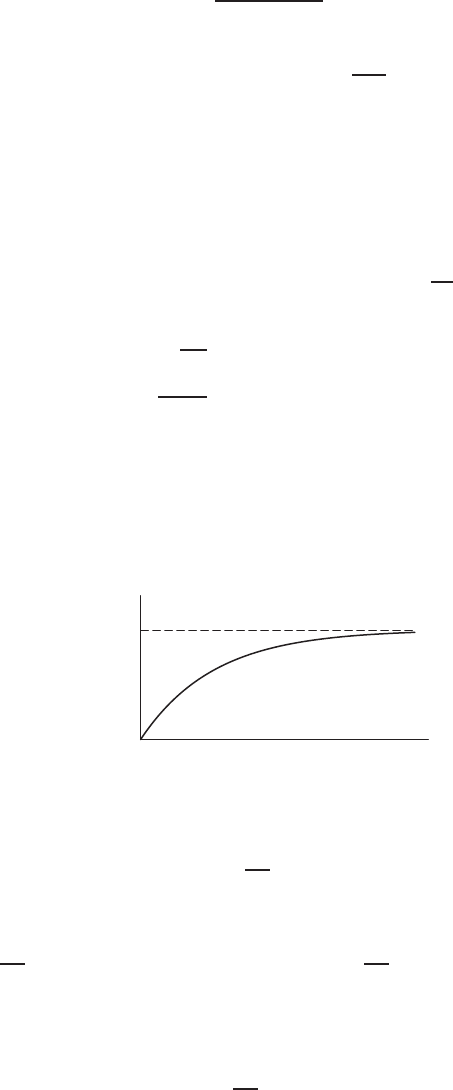
1070 Chapter Eleven /SOLUTIONS
(c) We solve the differential equation by separating variables and then integrating:
ZdB
0.08B−2000 =Zdt
12.5 ln |0.08B−2000|=t+C
ln |0.08B−2000|=t
12.5+C
0.08B−2000 = ±e0.08t+C
B= 25,000 + Ae0.08t.
(d) (i) If the initial deposit is 20,000, then we have B= 20,000 when t= 0, which leads to A=−5000. Knowing
A, we can find B(5) as:
B(5) = 25,000 −5000e0.08(5) = $17,540.88.
(ii) Now B= 30,000 when t= 0 leads to A= 5000, giving B(5) = $32,459.12.
10. Let D(t)be the quantity of dead leaves, in grams per square centimeter. Then dD
dt = 3 −0.75D, where tis in years. We
factor out −0.75 and then separate variables.
dD
dt =−0.75(D−4)
ZdD
D−4=Z−0.75 dt
ln |D−4|=−0.75t+C
|D−4|=e−0.75t+C=e−0.75teC
D= 4 + Ae−0.75t,where A=±eC.
If initially the ground is clear, the solution looks like the following graph:
4
t
D
The equilibrium level is 4 grams per square centimeter, regardless of the initial condition.
11. (a) Letting Prepresent the quantity of pollutant in the lake, in metric tons, in year t, we have
dP
dt =−0.16P+ 8.
Substituting P0= 45 and P0= 55, we get
dP
dt P=45
=−0.16(45) + 8 = 0.8and dP
dt P=55
=−0.16(55) + 8 = −0.8.
Since the derivative is positive for P0= 45, the quantity of pollutant is increasing then. For P0= 55, the derivative
is negative, so the quantity of pollutant is decreasing then.
(b) Writing the differential equation as
dP
dt =−0.16(P−50),
we use separation of variables to see that the general solution is
P= 50 + Ce−0.16t.
In all cases, the quantity of pollutant levels off at 50 metric tons after a long time.
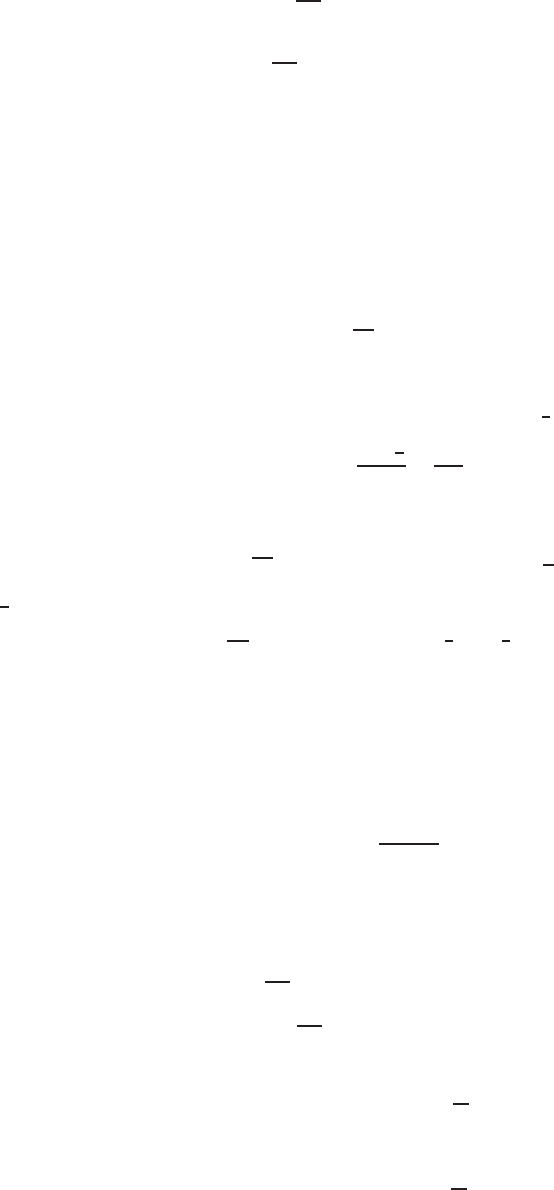
11.6 SOLUTIONS 1071
12. Caffeine is leaving the body at a rate of 17% per hour and is entering the body at a rate of 130 mg per hour, so the
differential equation is
dA
dt =−0.17A+ 130.
Writing the differential equation as
dA
dt =−0.17(A−764.706),
we use separation of variables to see that the general solution is A= 764.706 + Ce−0.17t. Since the initial condition is
A0= 0, we have C=−764.706 so the particular solution is
A= 764.706 −764.706e−0.17t.
We substitute t= 10 to find the amount of caffeine at 5 pm:
A= 764.706 −764.706e−0.17(10) = 625.007.
At 5 pm, the person has about 625 mg of caffeine in the body.
13. (a) If Iis intensity and lis the distance traveled through the water, then for some k > 0,
dI
dl =−kI.
(The proportionality constant is negative because intensity decreases with distance). Thus I=Ae−kl. Since I=A
when l= 0,Arepresents the initial intensity of the light.
(b) If 50% of the light is absorbed in 10 feet, then 0.50A=Ae−10k, so e−10k=1
2, giving
k=−ln 1
2
10 =ln 2
10 .
In 20 feet, the percentage of light left is
e−ln 2
10 ·20 =e−2 ln 2 = (eln 2)−2= 2−2=1
4,
so 3
4or 75% of the light has been absorbed. Similarly, after 25 feet,
e−ln 2
10 ·25 =e−2.5 ln 2 = (eln 2)−5
2= 2−5
2≈0.177.
Approximately 17.7% of the light is left, so 82.3% of the light has been absorbed.
14. (a) The differential equation for the population has the form
Rate of change =Birth rate −Death rate
The birth rate is 140 m/yr = 0.14 bn/yr. Since we assume the death rate is increasing linearly from 57 m/year to
80 m/year over 30 years, we have
Rate of change of death rate =80 −57
30 = 0.767(million/year)/year.
Then at time t, the death rate is given by
Death rate = 57 + 0.767tmillion/year = 0.057 + 0.000767tbillion/year.
The differential equation is
dP
dt = 0.14 −(0.057 + 0.000767t)
dP
dt = 0.083 −0.000767t.
(b) The differential equation can be solved by direct integration:
P= 0.083t−0.000767 t2
2+P0.
Since P0= 6.9billion is the population at t= 0, we have
P= 0.083t−0.000767 t2
2+ 6.9.

1072 Chapter Eleven /SOLUTIONS
(c) In 2050, we have t= 40, so
P= 0.083(40) −0.000767 402
2+ 6.9= 9.61 bn.
15. (a) If P=pressure and h=height, dP
dh =−3.7×10−5P, so P=P0e−3.7×10−5h.Now P0= 29.92,since pressure
at sea level (when h= 0) is 29.92, so P= 29.92e−3.7×10−5h.At the top of Mt. Whitney, the pressure is
P= 29.92e−3.7×10−5(14500) ≈17.50 inches of mercury.
At the top of Mt. Everest, the pressure is
P= 29.92e−3.7×10−5(29000) ≈10.23 inches of mercury.
(b) The pressure is 15 inches of mercury when
15 = 29.92e−3.7×10−5h
Solving for hgives h=−1
3.7×10−5ln( 15
29.92 )≈18,661.5feet.
16. (a) Since the rate of change of the weight is given by
dW
dt =1
3500 (Intake −Amount to maintain weight)
we have dW
dt =1
3500 (I−20W).
(b) To find the equilibrium, we solve dW/dt = 0, or
1
3500 (I−20W) = 0.
Solving for W, we get W=I/20.
This means that if an athletic adult male weighing I/20 pounds has a constant caloric intake of Icalories per
day, his weight remains constant. We expect the equilibrium to be stable because an athletic adult male slightly over
the equilibrium weight loses weight because his caloric intake is too low to maintain the higher weight. Similarly, an
adult male slightly under the equilibrium weight gains weight because his caloric intake is higher than required to
maintain his weight.
(c) Factoring the right side of the differential equation
dW
dt =1
3500 (I−20W) = −1
175 W−I
20 ,
we separate variables and integrate: ZdW
W−I/20 =−Z1
175 dt.
Thus we have
ln W−I
20 =−1
175 t+C
so that
W−I
20 =Ae−(1/175)t
or in other words
W=I
20 +Ae−(1/175)t.
Let us call the person’s initial weight W0at t= 0.Then W0=I/20 + Ce0, so C=W0−I/20. Thus
W=I
20 +W0−I
20 e−(1/175)t.

11.6 SOLUTIONS 1073
(d) Using part (c), we have W= 150 + 10e−(1/175)t.This means that W→150 as t→ ∞. See Figure 11.39.
100
days
150
160
t
W
Figure 11.39
17. (a) We know that the rate at which morphine leaves the body is proportional to the amount of morphine in the body at
that particular instant. If we let Qbe the amount of morphine in the body, we get that
Rate of morphine leaving the body =kQ,
where kis the rate of proportionality. The solution is Q=Q0ekt (neglecting the continuously incoming morphine).
Since the half-life is 2 hours, we have 1
2Q0=Q0ek·2,
so
k=ln(1/2)
2=−0.347.
(b) Since
Rate of change of quantity =Rate in −Rate out,
we have dQ
dt =−0.347Q+ 2.5.
(c) Equilibrium occurs when dQ/dt = 0, that is, when 0.347Q= 2.5or Q= 7.2mg.
18. Let the depth of the water at time tbe y. Then dy
dt =−k√y, where kis a positive constant. Separating variables,
Zdy
√y=−Zk dt,
so
2√y=−kt +C.
When t= 0, y = 36;2√36 = −k·0 + C, so C= 12.
When t= 1, y = 35;2√35 = −k+ 12,so k≈0.17.
Thus, 2√y≈ −0.17t+ 12.We are looking for tsuch that y= 0; this happens when t≈12
0.17 ≈71 hours, or about 3
days.
19. We are given that the rate of change of pressure with respect to volume, dP/dV is proportional to P/V , so that
dP
dV =kP
V.
Using separation of variables and integrating gives
ZdP
P=kZdV
V.
Evaluating these integral gives
ln P=kln V+c
or equivalently,
P=AV k.

1074 Chapter Eleven /SOLUTIONS
20. (a) If Ais surface area, we know that for some constant K
dV
dt =−KA.
If ris the radius of the sphere, V= 4πr3/3and A= 4πr2. Solving for rin terms of Vgives r= (3V /4π)1/3, so
dV
dt =−K(4πr2) = −K4π3V
4π2/3
so dV
dt =−kV 2/3
where kis another constant, k=K(4π)1/332/3.
(b) Separating variables gives
ZdV
V2/3=−Zk dt
3V1/3=−kt +C.
Since V=V0when t= 0, we have 3V1/3
0=C, so
3V1/3=−kt + 3V1/3
0.
Solving for Vgives
V=−k
3t+V1/3
03
.
This function is graphed in Figure 11.40.
3V1/3
0/k
V0
t
V
Figure 11.40
(c) The snowball disappears when V= 0, that is when
−k
3t+V1/3
0= 0
giving
t=3V1/3
0
k.
21. Let V(t)be the volume of water in the tank at time t, then
dV
dt =k√V
This is a separable equation which has the solution
V(t) = ( kt
2+C)2
Since V(0) = 200 this gives 200 = C2so
V(t) = ( kt
2+√200)2.
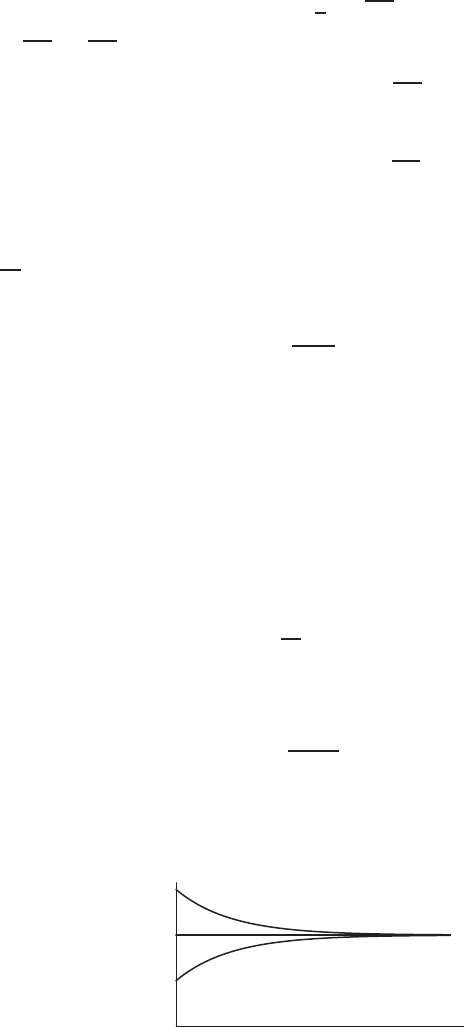
11.6 SOLUTIONS 1075
However, V(1) = 180 therefore
180 = ( k
2+√200)2,
so that k= 2 √180 −√200=−1.45146. Therefore,
V(t) = (−0.726t+√200)2.
The tank will be half-empty when V(t) = 100, so we solve
100 = (−0.726t+√200)2
to obtain t= 5.7days. The tank will be half empty in 5.7days.
The volume after 4 days is V(4) which is approximately 126.32 liters.
22. (a) We have dy
dt =−k(y−a), where k > 0and aare constants.
(b) Separating variables and integrating we have
Zdy
y−a=Z−k dt,
so
ln |y−a|= ln(y−a) = −kt +C.
Thus,
y−a=Ae−kt where A=eC.
Initially nothing has been forgotten, so y(0) = 1.Therefore, 1−a=Ae0=A, so y−a= (1 −a)e−kt or
y= (1 −a)e−kt +a.
(c) As t→ ∞, e−kt →0, so y→a.
Thus, arepresents the fraction of material which is remembered in the long run. The constant ktells us about the rate
at which material is forgotten.
23. (a) We have
dp
dt =−k(p−p∗),
where kis constant. Notice that k > 0,since if p > p∗then dp/dt should be negative, and if p < p∗then dp/dt
should be positive.
(b) Separating variables, we have Zdp
p−p∗=Z−k dt.
Solving, we find p=p∗+ (p0−p∗)e−kt,where p0is the initial price.
(c) See Figure 11.41.
p∗
t
p
p0> p∗
p0< p∗
Figure 11.41
(d) As t→ ∞, p →p∗.We see this in the solution in part (b), since as t→ ∞, e−kt →0.In other words, as t→ ∞,p
approaches the equilibrium price p∗.

1076 Chapter Eleven /SOLUTIONS
24. We have
The rate that people
first go see the movie
|{z }
dN/ dt
=k× The number of people who would
like to see it but haven’t yet !
|{z }
L−N
dN
dt =k(L−N)
ZdN
N−L=−Zk dt separation of variables
ln |N−L|=−kt +C
|N−L|=Be−kt B=eC
N−L=Ae−kt A=−B
N=L+Ae−kt.
Presumably no one sees the movie before it is released, so N= 0 on day t= 0, and we have
0 = L+Ae−k·0
A=−L
so N=L−Le−kt.
25. (a)
dQ
dt =r−αQ =−α(Q−r
α)
ZdQ
Q−r/α = = −αZdt
ln Q−r
α=−αt +C
Q−r
α=Ae−αt
When t= 0,Q= 0, so A=−r
αand
Q=r
α(1 −e−αt)
So,
Q∞= lim
t→∞ Q=r
α.
r
α
Q
t
Q=r
α(1 −e−αt)
(b) Doubling rdoubles Q∞. Since Q∞=r/α, the time to reach 1
2Q∞is obtained by solving
r
2α=r
α(1 −e−αt)
1
2= 1 −e−αt
e−αt =1
2
t=−ln(1/2)
α=ln 2
α.
So altering rdoes not alter the time it takes to reach 1
2Q∞. See Figure 11.42.

11.6 SOLUTIONS 1077
ln 2
α
r
α
2r
α
Q
t
Q=r
α(1 −e−αt)
Q=2r
α(1 −e−αt)
Figure 11.42
(c) Q∞is halved by doubling α, and so is the time, t=ln 2
α, to reach 1
2Q∞.
26. (a) Concentration of carbon monoxide =Quantity in room
Volume .
If Q(t)represents the quantity of carbon monoxide in the room at time t,c(t) = Q(t)/60.
Rate quantity of
carbon monoxide in room
changes
=rate in −rate out
Now
Rate in = 5%(0.002m3/min) = 0.05(0.002) = 0.0001m3/min.
Since smoky air is leaving at 0.002m3/min, containing a concentration c(t) = Q(t)/60 of carbon monoxide
Rate out = 0.002 Q(t)
60
Thus dQ
dt = 0.0001 −0.002
60 Q
Since c=Q/60, we can substitute Q= 60c, giving
d(60c)
dt = 0.0001 −0.002
60 (60c)
dc
dt =0.0001
60 −0.002
60 c
(b) Factoring the right side of the differential equation and separating gives
dc
dt =−0.0001
3(c−0.05) ≈3×10−5(c−0.05)
Zdc
c−0.05 =−Z3×10−5dt
ln |c−0.05|=−3×10−5t+K
c−0.05 = Ae−3×10−5twhereA=±eK.
Since c= 0 when t= 0, we have A=−0.05, so
c= 0.05 −0.05e−3×10−5t
(c) As t→ ∞,e−3×10−5t→0soc→0.05.
Thus in the long run, the concentration of carbon monoxide tends to 5%, the concentration of the incoming air.

1078 Chapter Eleven /SOLUTIONS
27. We have c= 0.05 −0.05e−3×10−5t. We want to solve for twhen c= 0.0002:
0.0002 = 0.05 −0.05e−3×10−5t
−0.0498 = −0.05e−3×10−5t
e−3×10−5t= 0.996
t=−ln(0.996)
3×10−5=133.601 min.
28. (a) Now
dS
dt =(Rate at which salt enters the pool) −(Rate at which salt leaves the pool),
and, for example,
Rate at which salt
enters the pool != Concentration of
salt solution !× Flow rate of
salt solution !
(grams/minute) =(grams/liter) ×(liters/minute)
so
Rate at which salt enters the pool =
(10 grams/liter) ×(60 liters/minute) =(600 grams/minute)
The rate at which salt leaves the pool depends on the concentration of salt in the pool. At time t, the concentration is
S(t)
2×106liters , where S(t)is measured in grams.
Thus
Rate at which salt leaves the pool =
S(t)grams
2×106liters ×60 liters
minute =3S(t)grams
105minutes .
Thus dS
dt = 600 −3S
100,000 .
(b) dS
dt =−3
100,000 (S−20,000,000)
RdS
S−20,000,000 =R−3
100,000 dt
ln |S−20,000,000|=−3
100,000 t+C
S= 20,000,000 −Ae−3
100,000 t
Since S= 0 at t= 0, A = 20,000,000.Thus S(t) = 20,000,000 −20,000,000e−3
100,000 t.
(c) As t→ ∞, e−3
100,000 t→0,so S(t)→20,000,000 grams. The concentration approaches 10 grams/liter. Note that
this makes sense; we’d expect the concentration of salt in the pool to become closer and closer to the concentration
of salt being poured into the pool as t→ ∞.
29. We are given that
BC = 2OC.
If the point Ahas coordinates (x, y)then OC =xand AC =y. The slope of the tangent line, y′, is given by
y′=AC
BC =y
BC ,
so
BC =y
y′.
Substitution into BC = 2OC gives y
y′= 2x,
so y′
y=1
2x.

11.6 SOLUTIONS 1079
Separating variables to integrate this differential equation gives
Zdy
y=Zdx
2x
ln |y|=1
2ln |x|+C= ln p|x|+ ln A
|y|=Ap|x|
y=±(A√x).
Thus, in the first quadrant, the curve has equation y=A√x.
30. (a) Newton’s Law of Motion says that
Force = (mass)×(acceleration).
Since acceleration, dv/dt, is measured upward and the force due to gravity acts downward,
−mgR2
(R+h)2=mdv
dt
so
dv
dt =−gR2
(R+h)2.
(b) Since v=dh
dt , the chain rule gives
dv
dt =dv
dh ·dh
dt =dv
dh ·v.
Substituting into the differential equation in part (a) gives
vdv
dh =−gR2
(R+h)2.
(c) Separating variables gives
Zv dv =−ZgR2
(R+h)2dh
v2
2=gR2
(R+h)+C
Since v=v0when h= 0,
v02
2=gR2
(R+ 0) +Cgives C=v02
2−gR,
so the solution is
v2
2=gR2
(R+h)+v02
2−gR
v2=v02+2gR2
(R+h)−2gR
(d) The escape velocity v0ensures that v2≥0for all h≥0. Since the positive quantity 2gR2
(R+h)→0as h→ ∞, to
ensure that v2≥0for all h, we must have
v02≥2gR.
When v02= 2gR so v0=√2gR, we say that v0is the escape velocity.
31. (a) For this situation,
Rate money added
to account != Rate money added
via interest !+ Rate money
deposited !.
Translating this into an equation yields
dB
dt = 0.05B+ 1200.

1080 Chapter Eleven /SOLUTIONS
(b) Solving this equation via separation of variables gives
dB
dt = 0.05B+ 1200
= 0.05(B+ 24000).
So ZdB
B+ 24000 =Z0.05 dt,
and
ln |B+ 24000|= 0.05t+C.
Solving for Bgives
|B+ 24000|=e0.05t+C=eCe0.05t,
so
B=Ae0.05t−24000,(where A=ec).
We may find Ausing the initial condition B0=f(0) = 0
A−24000 = 0 or A= 24000.
The solution is
B= 24,000e0.05t−24,000.
(c) After 5 years, the balance is
B=f(5) = 24,000(e0.05(5) −1) = 6816.61 dollars.
32. (a) The balance in the account at the beginning of the month is given by the following sum
balance in
account =previous month’s
balance +interest on
previous month’s balance +monthly deposit
of $100
Denote month i’s balance by Bi. Assuming the interest is compounded continuously, we have
previous month’s
balance !+ interest on previous
month’s balance !=Bi−1e0.1/12.
Since the interest rate is 10% = 0.1per year, interest is 0.1
12 per month. So at month i, the balance is
Bi=Bi−1e0.1
12 + 100
Explicitly, we have for the five years (60 months) the equations:
B0= 0
B1=B0e0.1
12 + 100
B2=B1e0.1
12 + 100
B3=B2e0.1
12 + 100
.
.
..
.
.
B60 =B59e0.1
12 + 100
In other words,
B1= 100
B2= 100e0.1
12 + 100
B3= (100e0.1
12 + 100)e0.1
12 + 100
= 100e(0.1)2
12 + 100e0.1
12 + 100
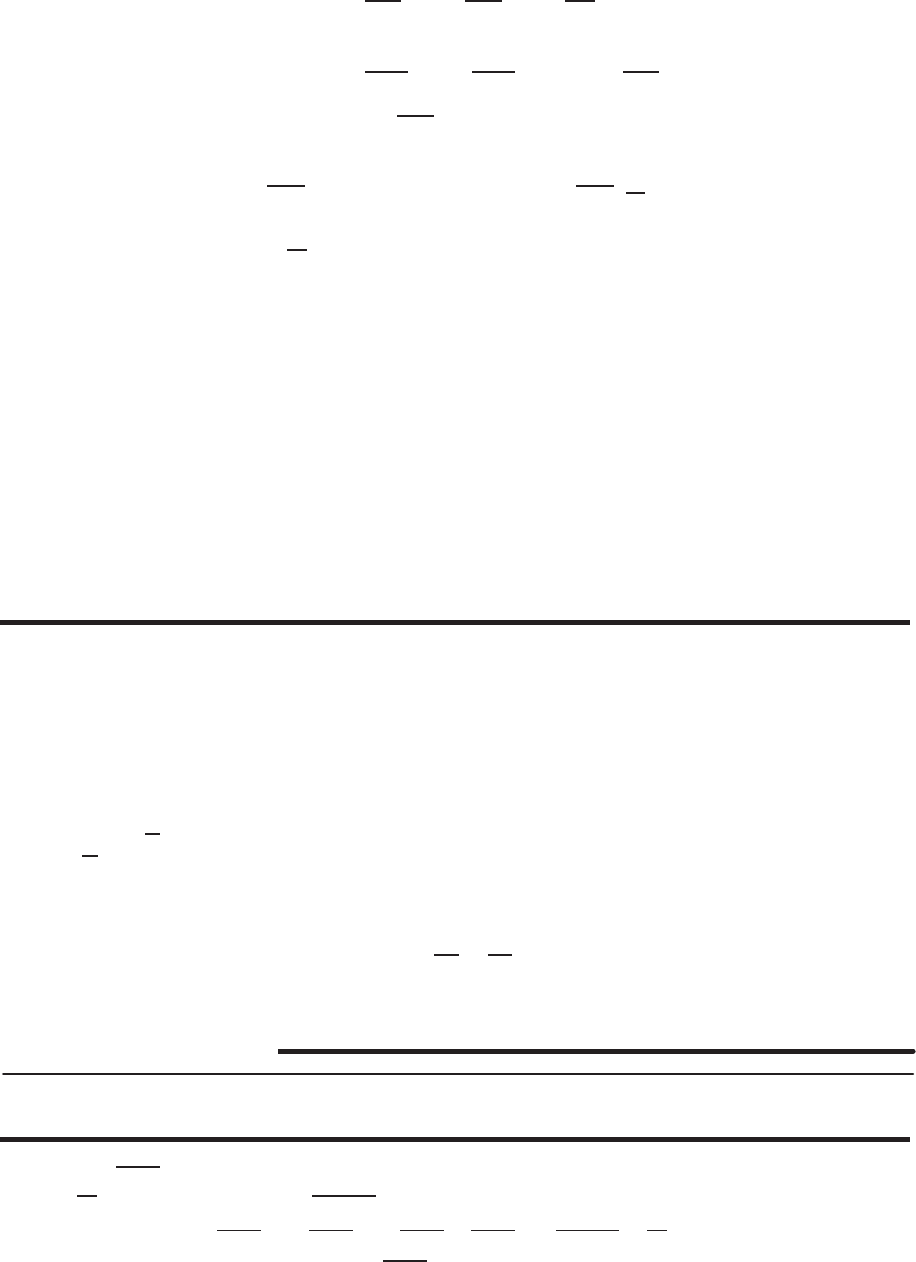
11.7 SOLUTIONS 1081
B4= 100e(0.1)3
12 + 100e(0.1)2
12 + 100e(0.1)
12 + 100
.
.
..
.
.
B60 = 100e(0.1)59
12 + 100e(0.1)58
12 +··· + 100e(0.1)1
12 + 100
B60 =
59
X
k=0
100e(0.1)k
12
(b) The sum B60 =
59
X
k=0
100e(0.1)k
12 can be written as B60 =
59
X
k=0
1200e(0.1)k
12 (1
12 )which is the left Riemann sum for
Z5
0
1200e0.1tdt, with ∆t=1
12 and N= 60. Evaluating the sum on a calculator gives B60 = 7752.26.
(c) The situation described by this problem is almost the same as that in Problem 31, except that here the money is being
deposited once a month rather than continuously; however the nominal yearly rates are the same. Thus we would
expect the balance after 5 years to be approximately the same in each case. This means that the answer to part (b)
of this problem should be approximately the same as the answer to part (c) to Problem 31. Since the deposits in this
problem start at the end of the first month, as opposed to right away, we would expect the balance after 5 years to be
slightly smaller than in Problem 31, as is the case.
Alternatively, we can use the Fundamental Theorem of Calculus to show that the integral can be computed
exactly Z5
0
1200e0.1tdt = 12000(e(0.1)5 −1) = 7784.66
Thus R5
01200e0.1tdt represents the exact solution to Problem 31. Since 1200e0.1tis an increasing function, the left
hand sum we calculated in part (b) of this problem underestimates the integral. Thus the answer to part (b) of this
problem should be less than the answer to part (c) of Problem 31.
Strengthen Your Understanding
33. When we substitute B= 5000 into the differential equation, we see that dB/dt = 0.08(5000) −250 = 150 >0. Since
the rate of change is positive, the balance is increasing.
34. The units do not match up. If time tis measured in days, we need to convert 25 mg per hour to the equivalent rate of 600
mg per day. If time tis measured in hours, we need to convert the rate 15% per day into the equivalent rate of 0.625% per
hour.
35. We use Qfor the quantity of drug in the body at time t. The rate in is constant (such as 50) and the rate out is proportional
(such as 0.08Q). One possible answer is dQ/dt = 50 −0.08Q. Other answers are possible.
36. We use Qfor the size of the quantity at time t. The rate due to its growth on its own is proportional to the cube root
(such as 0.23
√Q) and the rate due to the external contribution is constant (such as 100). One possible answer is dQ/dt =
0.23
√Q+ 100.
37. We use Qfor the size of the quantity at time t. Since the rate of growth dQ/dt goes down as Qgoes up, one possible
model is that the rate of growth is inversely proportional to Q. We have dQ/dt =k/Q with kpositive. One example is
dQ
dt =0.5
Q.
Other answers are possible.
Solutions for Section 11.7
Exercises
1. (a) P=1
1+e−t= (1 + e−t)−1
dP
dt =−(1 + e−t)−2(−e−t) = e−t
(1+e−t)2.
Then P(1 −P) = 1
1+e−t1−1
1+e−t=1
1+e−te−t
1+e−t=e−t
(1+e−t)2=dP
dt .
(b) As ttends to ∞, e−tgoes to 0. Thus lim
t→∞
1
1+e−t= 1.

1082 Chapter Eleven /SOLUTIONS
2. We know that there is an equilibrium solution at the carrying capacity P= 100 and that Pincreases toward 100 if
0< P < 100 and Pdecreases toward 100 if P > 100. Furthermore, we know that there is an inflection point at a height
of P= 100/2 = 50 and that the graph is concave up for 0< P < 50 and is concave down for 50 < P < 100. See
Figure 11.43.
50
100
(a)
(b)
(c)
t
P
Figure 11.43
3. We know that there is an equilibrium solution at the carrying capacity Q= 1/0.0004 = 2500 and that Qincreases toward
2500 if 0< Q < 2500 and Qdecreases toward 2500 if Q > 2500. Furthermore, we know that there is an inflection
point at a height of Q= 2500/2 = 1250 and that the graph is concave up for 0< Q < 1250 and is concave down for
1250 < Q < 2500. See Figure 11.44.
1250
2500
(a)
(b)
(c)
x
y
Figure 11.44
4. Since dP/dt is a quadratic function of Pwith negative leading coefficient, the graph of dP/dt against Pis a parabola
opening down. Since dP/dt = 0 when P= 0 and when P= 250, the horizontal intercepts of the parabola are at 0 and
250. See Figure 11.45. Since we don’t know the value of k, we can’t put a scale on the vertical axis.
250 P
dP/dt
Figure 11.45
5. Since dA/dt is a quadratic function of Awith negative leading coefficient, the graph of dA/dt against Ais a parabola
opening down. Since dA/dt = 0 when A= 0 and when A= 1/0.0002 = 5000, the horizontal intercepts of the parabola
are at 0 and 5000. See Figure 11.46. Since we don’t know the value of k, we can’t put a scale on the vertical axis.
5000 A
dA/dt
Figure 11.46
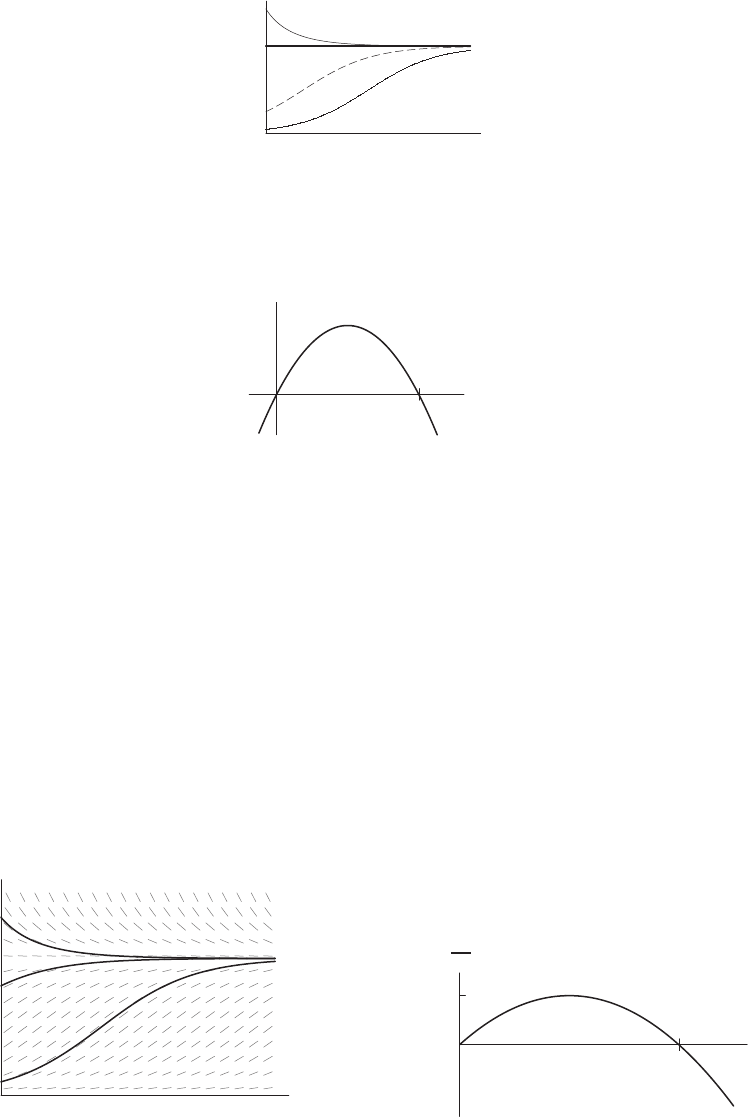
11.7 SOLUTIONS 1083
6. We see in Figure 11.69 that dP/dt = 0 when P= 0 and when P= 45. Thus, there are equilibrium solutions at P= 0
and at P= 45. If 0< P < 45, the derivative dP/dt is positive so Pis an increasing function of t. If P < 0or P > 45,
the derivative dP/dt is negative so Pis a decreasing function of t. See Figure 11.47.
45
t
P
Figure 11.47
7. We see in Figure 11.70 that there appear to be equilibrium solutions at Q= 0 and Q= 800. Thus, the graph of dQ/dt
against Qwill have horizontal intercepts at Q= 0 and Q= 800. Since Qis growing logistically, the graph of dQ/dt
against Qis a parabola opening down. See Figure 11.48.
800 Q
dQ/dt
Figure 11.48
8. (a) See Figure 11.49.
(b) The value P= 1 is a stable equilibrium. (See part (d) below for a more detailed discussion.)
(c) Looking at the solution curves, we see that Pis increasing for 0< P < 1and decreasing for P > 1. The values of
P= 0,P= 1 are equilibria. In the long run, Ptends to 1, unless you start with P= 0. The solution curves with
initial populations of less than P= 1/2have inflection points at P= 1/2. (This will be demonstrated algebraically
in part (d) below.) At the inflection point, the population is growing fastest.
(d) See Figure 11.50.
Since dP/dt = 3P−3P2= 3P(1 −P), the graph of dP/dt against Pis a parabola, opening downward
with Pintercepts at 0 and 1. The quantity dP/dt is positive for 0< P < 1, negative for P > 1(and P < 0). The
quantity dP/dt is 0 at P= 0 and P= 1, and maximum at P= 1/2. The fact that dP/dt = 0 at P= 0 and P= 1
tells us that these are equilibria. Further, since dP/dt > 0for 0< P < 1, solution curves starting here increase
toward P= 1.
If the population starts at a value P < 1/2, it increases at an increasing rate up to P= 1/2. After this, P
continues to increase, but at a decreasing rate. The fact that dP/dt has a maximum at P= 1/2tells us that there is a
point of inflection when P= 1/2. Similarly, since dP/dt < 0for P > 1, solution curves starting with P > 1will
decrease to P= 1. Thus, P= 1 is a stable equilibrium.
1 2
1
t
P
Figure 11.49
1
0.75
P
dP
dt
Figure 11.50

1084 Chapter Eleven /SOLUTIONS
9. (a) Equilibrium values are values where dP/dt = 0, so the equilibrium values are at P= 0 and P= 2000.
(b) At P= 500, we see that dP/dt is positive so Pis increasing.
10. (a) Equilibrium values are values where dP/dt = 0, so the equilibrium values are at P= 0 and P= 400.
(b) At P= 500, we see that dP/dt is negative so Pis decreasing.
11. (a) We see that k= 0.035 which tells us that the quantity Pgrows by about 3.5% per unit time when Pis very small
relative to L. We also see that L= 6000 which tells us the upper limit on the value of Pif Pis initially below 6000.
(b) The largest rate of change occurs when P=L/2 = 3000.
12. (a) We factor out 0.1Pon the right hand side to obtain dP/dt = 0.1P(1 −0.0008P). We see that k= 0.1which
tells us that the quantity Pgrows by about 10% per unit time when Pis very small relative to L. We also see that
L= 1/0.0008 = 1250 which tells us the upper limit on the value of Pif Pis initially below 1250.
(b) The largest rate of change occurs when P=L/2 = 625.
13. We see from the differential equation that k= 0.05 and L= 2800, so the general solution is
P=2800
1 + Ae−0.05t.
14. We see from the differential equation that k= 0.012 and L= 5700, so the general solution is
P=5700
1 + Ae−0.012t.
15. We see from the differential equation that k= 0.68 and L= 1/0.00025 = 4000, so the general solution is
P=4000
1 + Ae−0.68t.
16. We factor out 0.2Pto obtain dP/dt = 0.2P(1 −0.004P). We see that k= 0.2and L= 1/0.004 = 250, so the general
solution is
P=250
1 + Ae−0.2t.
17. We rewrite
10P−5P2= 10P1−P
2,
so k= 10 and L= 2. Since P0=L/4, we have A= (L−P0)/P0= 3. Thus
P=2
1 + 3e−10t.
The time to peak dP/dt is
t=1
kln A= ln(3)/10.
18. We rewrite
0.02P−0.0025P2= 0.02P1−P
8,
so k= 0.02 and L= 8. Since P0= 1, we have A= (8 −1)/1 = 7. Thus
P=8
1 + 7e−0.02t.
The time of peak dP/dt is
t=1
kln A=1
0.02 ln 7 = 50 ln 7.
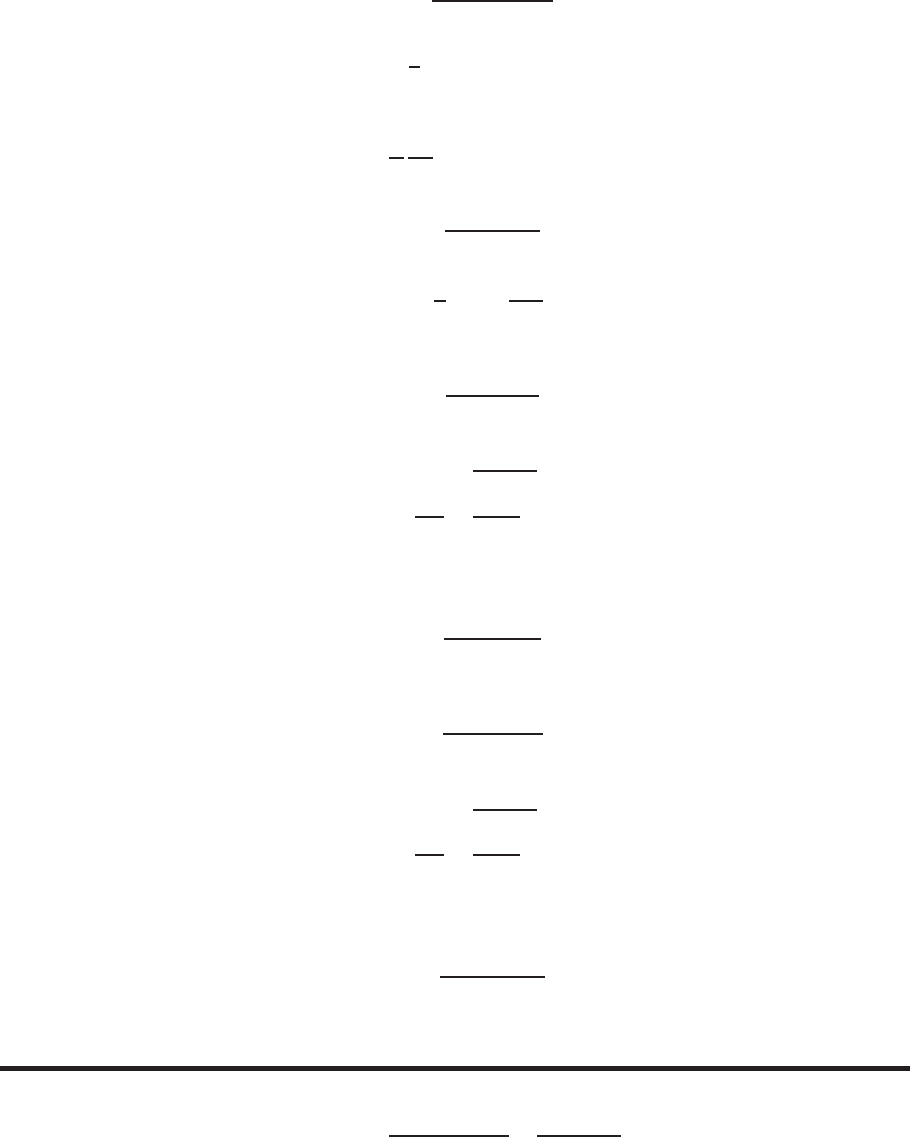
11.7 SOLUTIONS 1085
19. We can immediately read off k= 0.3, L = 100.Since P0= 75, we have A= (L−P0)/P0= (100 −75)/75 = 1/3.
Thus
P=100
1 + (1/3)e−0.3t.
The time to peak dP/dt is
t=1
kln A=−ln(3)/0.3.
Note that the time to peak dP/dt is negative since P0> L/2.
20. Rewriting the differential equation:
1
P
dP
dt = 0.12 −0.02P,
so k= 0.12 and −k/L =−0.02. Thus L= 0.12/0.02 = 6. Since A= (6 −2)/2 = 2, we have
P=6
1 + 2e−0.12t.
The time to peak dP/dt is
t=1
kln A=ln 2
0.12 .
21. We see from the differential equation that k= 0.8and L= 8500, so the general solution is
P=8500
1 + Ae−0.8t.
We substitute t= 0 and P= 500 to solve for the constant A:
500 = 8500
1 + Ae0
1
500 =1 + A
8500
17 = 1 + A
A= 16.
The solution to this initial value problem is
P=8500
1 + 16e−0.8t.
22. We see from the differential equation that k= 0.04 and L= 1/0.0001 = 10,000, so the general solution is
P=10000
1 + Ae−0.04t.
We substitute t= 0 and P= 200 to solve for the constant A:
200 = 10000
1 + Ae0
1
200 =1 + A
10000
50 = 1 + A
A= 49.
The solution to this initial value problem is
P=10,000
1 + 49e−0.04t.
Problems
23. (a) Substituting the value t= 0 we get
N(0) = 400
1 + 399e−0.4(0) =400
1 + 399(1) = 1.
The fact that N(0) = 1 tells us that at the moment the rumor begins spreading, there is only one person who knows
the content of the rumor.

1086 Chapter Eleven /SOLUTIONS
(b) Substituting t= 2 we get
N(2) = 400
1 + 399e−0.4(2) =400
1 + 399(0.449) = 2.
Substituting in t= 10 we get
N(10) = 400
1 + 399e−0.4(10) =400
1 + 7.308 = 48.
(c) The graph of N(t)is shown in Figure 11.51.
5 10 15 20
200
400
t
N(t)
Figure 11.51
(d) We are asked to find the time tat which 200 people will have heard the rumor. We can use the formula in the text
t=1
kln A=1
0.4ln 399 = 14.972.
Alternatively we can solve the equation
200 = 400
1 + 399e−0.4t.
We get
1 + 399e−0.4t=400
200 = 2
399e−0.4t= 1
e−0.4t=1
399
ln e−0.4t= ln 1
399
−0.4t= ln(1/399)
t=ln(1/399)
−0.4= 14.972.
Thus, after about 15 hours half the people have heard the rumor.
We are asked to solve for the time at which 399 people (that is, virtually everyone) will have heard the rumor.
We solve
399 = N(t) = 400
1 + 399e−0.4t
1 + 399e−0.4t=400
399
399e−0.4t=400
399 −1
e−0.4t=1
399 400
399 −1=400/399 −1
399
ln e−0.4t= ln 400/399 −1
399
−0.4t= ln 400/399 −1
399
t=ln((400/399 −1)/399)
−0.4= 29.945.
Thus, after approximately 30 hours 399 people (virtually everyone) will have heard the rumor.
(e) The rumor is spreading fastest at L/2 = 400/2 = 200 or when 200 people have already heard the rumor, so after
about 15 hours.

11.7 SOLUTIONS 1087
24. (a) At t= 0, which corresponds to 1935, we have
P=1
1 + 2.968e−0.0275(0) = 0.252
showing that about 25% of the land was in use in 1935.
(b) This model predicts that as tgets very large, Pwill approach 1. That is, the model predicts that in the long run, all
the land will be used for farming.
(c) The time when half the land is in use is the time at which dP/dt is greatest. This occurs when
t=1
kln A=1
0.0275 ln(2.968) = 39.6years.
Since t= 0 corresponds to 1935, t= 39.6corresponds to 1935 + 39.6 = 1974.6. According to this model, the
Tojolobal were using half their land in 1974.
(d) The inflection point occurs when P=L/2or at one-half the carrying capacity. In this case, P=1
2in 1974, as
shown in part (c).
25. (a) The equilibrium population occurs when dP /dt is zero. Solving
dP
dt = 1 −0.0004P= 0
gives P= 2500 fish as the equilibrium population.
(b) The solution of the differential equation is
P(t) = 2500
1 + Ae−0.25t
subject to P(−10) = 1000 if t= 0 represents the present time. So we have
1000 = 2500
(1 + Ae2.5)
from which A= 0.123127 and
P(0) = 2500
(1 + 0.123127) ≈2230.
Therefore, the current population is approximately 2230 fish.
(c) The effect of losing 10% of the fish each year gives the revised differential equation
dP
dt = (0.25 −0.0001P)P−0.1P
or dP
dt = (0.15 −0.0001P)P.
The revised equilibrium population occurs where dP/dt = 0, or about 1500 fish.
26. (a) The maximum rate of change occurs at approximately t= 50 and the rate of change at that point is approximately
(270 −195)/(50 −40) = 7.5.
(b) The maximum rate of change occurs at the point where P= 270 so we estimate that the carrying capacity is
approximately 270 ·2 = 540.
27. (a) The limiting value of f(t)is about 36, so the total number of infected computers is about 36,000.
(b) The curve has an inflection point at about t≈16 hours, and then n=f(16) ≈18.
(c) The virus was spreading fastest at about when t= 16, that is at 4 pm on July 19, 2001. At that time, about 18,000
computers were infected.
(d) At the inflection point, the number of computers infected is about half the number infected in the long run.
28. Let rbe the relative growth rate, that is r= (1/N)dN/ dt. Since ris a linear function of N, its graph contains the points
(N, r) = (5,15%) and (N, r) = (10,14.5%), so its slope is
m=∆r
∆N=0.145 −0.15
10 −5=−0.005
5=−0.001.
Using the point (5,0.15), we have
r= 0.15 −0.001(N−5)
r= 0.155 −0.001N.

1088 Chapter Eleven /SOLUTIONS
This gives us the differential equation
1
N
dN
dt = 0.155 −0.001N
dN
dt =N(0.155 −0.001N).
We see that dN/ dt = 0 where N= 0 or where
0.155 −0.001N= 0
0.001N= 0.155
N= 155.
Our model predicts the spread of pigweed will halt when 155 million acres are afflicted.
29. (a) Using the approximation
dP
dt ≈P(t+ 1) −P(t)
1,
we see that dP/dt and annual production are approximately equal.
For 1993 we have dP/dt = 22.0billion barrels per year.
For 2008 we have dP/dt = 26.9billion barrels per year.
(b) For 1993 we have
1
P
dP
dt =22.0
724 = 0.0304/year = 3.04% per year.
For 2008 we have 1
P
dP
dt =26.9
1100 = 0.0245/year = 2.45% per year.
(c) We are finding the equation of the line that contains the two points (724,0.0304) and (1100,0.0245). The slope
between these points is
Slope =0.0245 −0.0304
1100 −724 =−0.0000157.
Thus, the fitted line has an equation of the form
1
P
dP
dt =k−0.0000157P.
Using the point P= 724,(1/P )dP/dt = 0.0304, we solve for the vertical intercept k:
0.0304 = k−0.0000157(724)
k= 0.0304 + 0.0000157(724) = 0.0418.
Thus, the equation of the line is
1
P
dP
dt =−0.0000157P+ 0.0418.
(d) The total quantity, L. of world oil reserves in 1859 is the value of Pmaking dP/dt = 0, so it is the horizontal
intercept of the line we computed in (c). We solve
0 = −0.0000157P+ 0.0418
for Pto obtain P= 2662. This model estimates the total world oil reserves in 1859 to be L= 2662 billion barrels.
(e) Using t= 0 for 1993, we have the differential equation
dP
dt = 0.0418P1−P
2662 .
The solution is
P=2662
1 + Ae−0.0418t,
where A= (2662 −724)/724 = 2.677.So, in billions of barrels, we have
P=2662
1 + 2.677e−0.0418t.

11.7 SOLUTIONS 1089
30. (a) Using the formula on page 632 of the text for the time which gives the maximum value of dP/dt we have
t=1
kln A=1
0.0418 ln 2.677 = 23.6years.
So peak worldwide oil production is projected to occur about the year 1993 + 24 = 2017.
(b) Using the formula on page 632 of the text for the maximum value of (1/P )dP/dt with k= 0.0418 and L= 3500
we have
t=1
kln L−P0
P0
=1
0.0418 ln 3500 −724
724 = 32.2years.
So peak worldwide oil production is projected to occur about the year 1993 + 32 = 2025.
31. (a) The differential equation is
dP
dt = 0.0418P1−P
2662 .
The predicted values of dP/dt for 1998 and 2003 are
dP
dt 1998
= 0.0418 ·841 1−841
2662 = 24.0billion barrels per year
dP
dt 2003
= 0.0418 ·964 1−964
2662 = 25.7billion barrels per year.
Comparison with the actual annual production values, 24.4 bn barrel in 1998 and 25.3 bn barrel in 2003, we see the
model fits the data well. In each case, the prediction is about 0.4/25 ≈0.016 ≈2% from the the actual values. See
Figure 11.52.
500 1000 1500
10
20
30
1993
1998 2003
2008
P
(bn barrel)
dP/dt
(bn barrel/yr)
Figure 11.52
(b) The point (0,724) lies exactly on the curve, since the data for 1993 was used to find the solution to the differential
equation. The predicted values are
In 1998, P=2662
1 + 2.677e−0.0418·5= 839.2billion barrels
In 2003, P=2662
1 + 2.677e−0.0418·10 = 963.6billion barrels
In 2008, P=2662
1 + 2.677e−0.0418·15 = 1095.5billion barrels.
These values very close to the actual values of 841, 940, 1100 billion barrels—less than 1/2% difference. See Fig-
ure 11.53.
1993 2008 2043
1000
2000
2662
1993
1998
2003 2008
t
(year)
P
(bn barrel)
Figure 11.53
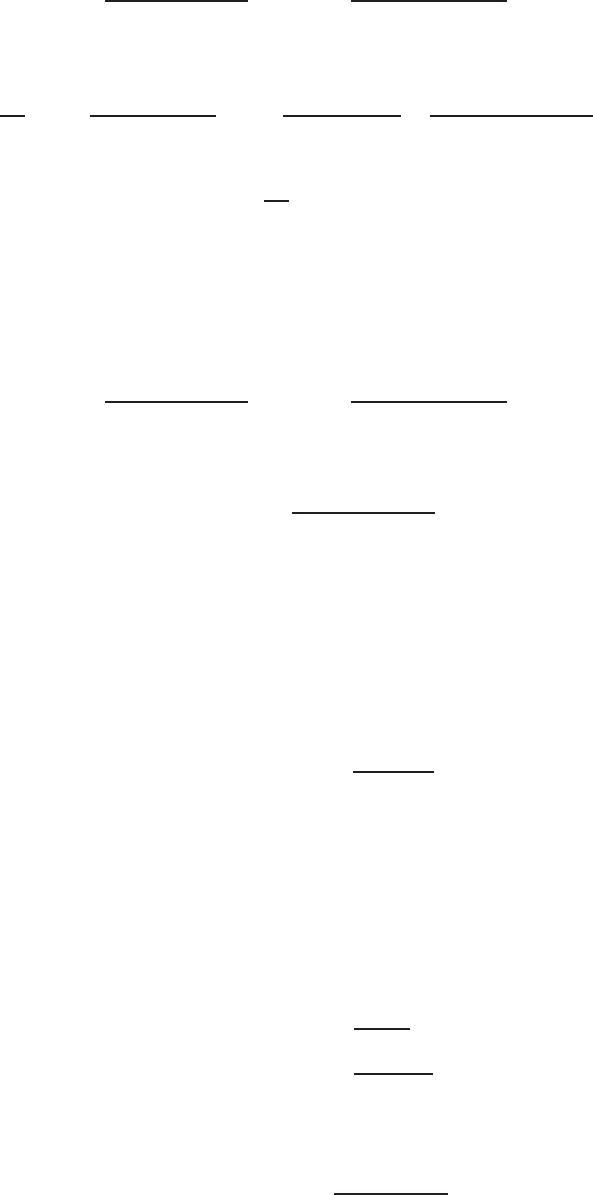
1090 Chapter Eleven /SOLUTIONS
32. (a) Since t= 0 is in 1993, for 2010, we substitute t= 17 into the logistic function
P=2662
1 + 2.677e−0.0418tso P=2662
1 + 2.677e−0.0418·17 = 1149.722 bn barrels.
(b) To estimate the quantity of oil produced during 2010, we can use a difference quotient or a derivative. We can find
P= 1177.098 billion barrels when t= 18 (in 2011) and use the approximation
dP
dt 2010 ≈P(t+ 1) −P(t)
1t=17
=P(18) −P(17)
1=1177.098 −1149.722
1= 27.376 bn barrels.
The derivative gives a similar value:
dP
dt t=17
= 27.302 bn barrels.
(c) Since the original reserves were estimated to be L= 2662 bn barrels, the oil projected to remain is 2662 −
1149.722 = 1512.278 billion barrels.
(d) The difference between the projection and the actual value is 27.376 −26.9 = 0.476 billion barrels, or about half a
billion in 2010.
More precisely, the estimate is 0.476/26.9 = 0.018 ≈2% too high—quite close.
33. (a) Since t= 0 is in 1993, for 2020, we substitute t= 27 into the logistic function
P=2662
1 + 2.677e−0.0418tso P=2662
1 + 2.677e−0.0418·27 = 1426.603 bn barrels.
(b) When 300 billion barrels of oil remain, then 2662 −300 = 2362 billion barrels of oil have been produced. We are
solving P(t) = 2362 for t:
2662
1 + 2.677e−0.0418t= 2362
2362 + 2362(2.677e−0.0418t) = 2662
2362(2.677e−0.0418t) = 300
e−0.0418t= 0.0474
−0.0418t= ln 0.0474
t= 72.9years.
So, in about 1993 + 73 = 2066, only 300 billion barrels of oil are projected to remain in the ground.
34. (a) We know that a logistic curve can be modeled by the function
P=L
1 + Ae−kt
where A= (L−P0)/(P0)and Pis the number of people infected by the virus at a particular time t. We know that
Lis the limiting value, or the maximal number of people infected with the virus, so in our case
L= 5000.
We are also told that initially there are only ten people infected with the virus so that we get
P0= 10.
Thus we have
A=L−P0
P0
=5000 −10
10
= 499.
We are also told that in the early stages of the virus, infection grows exponentially with k= 1.78. Thus we get that
the logistic function for people infected is
P=5000
1 + 499e−1.78t.
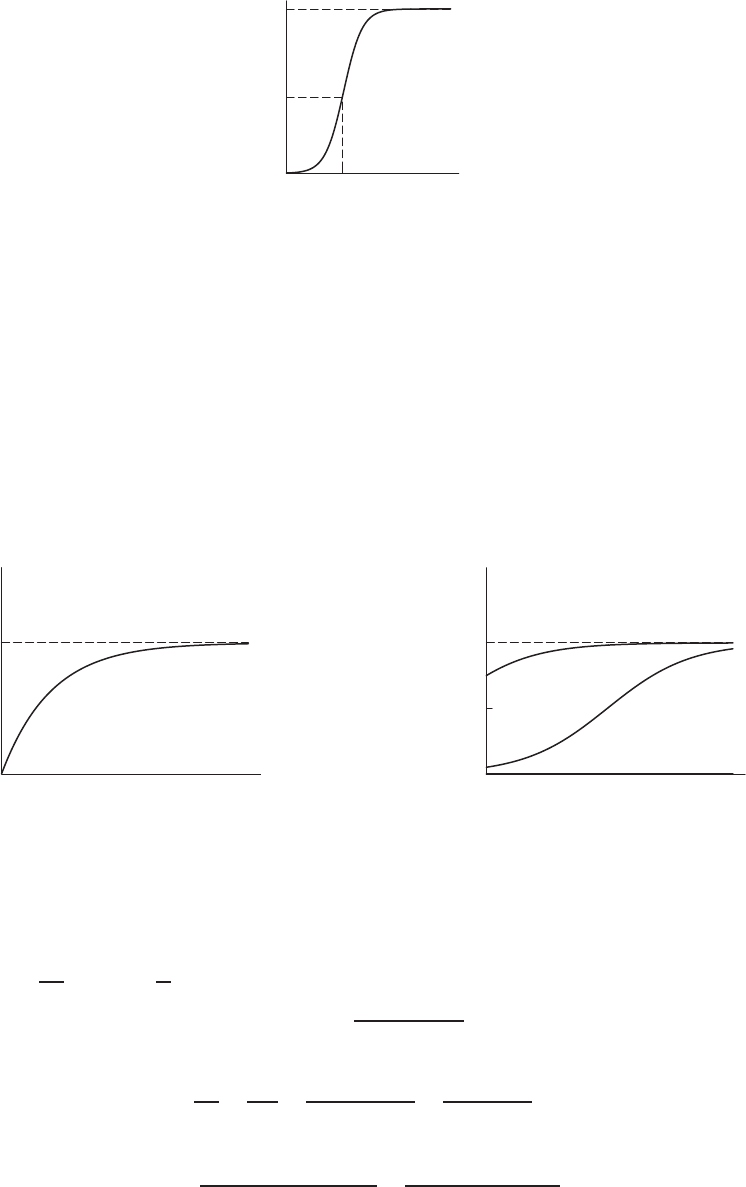
11.7 SOLUTIONS 1091
(b) See Figure 11.54.
3.5
2500
5000
t
y
Figure 11.54
(c) Looking at the graph we see that the the point at which the rate changes from increasing to decreasing, the inflection
point, occurs at roughly t= 3.5giving a value of P= 2500. Thus after roughly 2500 people have been infected, the
rate of infection starts dropping. See above.
35. (a) Let Ibe the number of informed people at time t, and I0the number who know initially. Then this model predicts
that dI/dt =k(M−I)for some positive constant k. Solving this, we find the solution is
I=M−(M−I0)e−kt.
We sketch the solution with I0= 0. Notice that dI/dt is largest when Iis smallest, so the information spreads fastest
in the beginning, at t= 0. In addition, Figure 11.55 shows that I→Mas t→ ∞, meaning that everyone gets the
information eventually.
(b) In this case, the model suggests that dI/dt =kI(M−I)for some positive constant k. This is a logistic model with
carrying capacity M. We sketch the solutions for three different values of I0in Figure 11.56.
M
t
I
Figure 11.55
I0= 0
I0= 0.05M
I0= 0.75M
0.5M
M
t
I
Figure 11.56
(i) If I0= 0 then I= 0 for all t. In other words, if nobody knows something, it does not spread by word of mouth!
(ii) If I0= 0.05M, then dI/dt is increasing up to I=M/2.Thus, the information is spreading fastest at I=M/2.
(iii) If I0= 0.75M, then dI/dt is always decreasing for I > M/2, so dI/dt is largest when t= 0.
36. (a) Figure 11.57 shows that the yeast population seems to stabilize at about 13, so we take this to be the limiting value,
L.
(b) Solving dP
dt =kP (1 −P
L)for k, we get:
k=dP/dt
P·(1 −P/L).
We now find dP /dt from the first two data points.
dP
dt ≈∆P
∆t=P(10) −P(0)
10 −0=8.87 −0.37
10 = 0.85.
Putting in our values for dP/dt,L, and P(10), we get:
k≈dP/dt
P(10) ·(1 −P(10)/L)=0.85
(8.87)(1 −8.87/13) = 0.30.
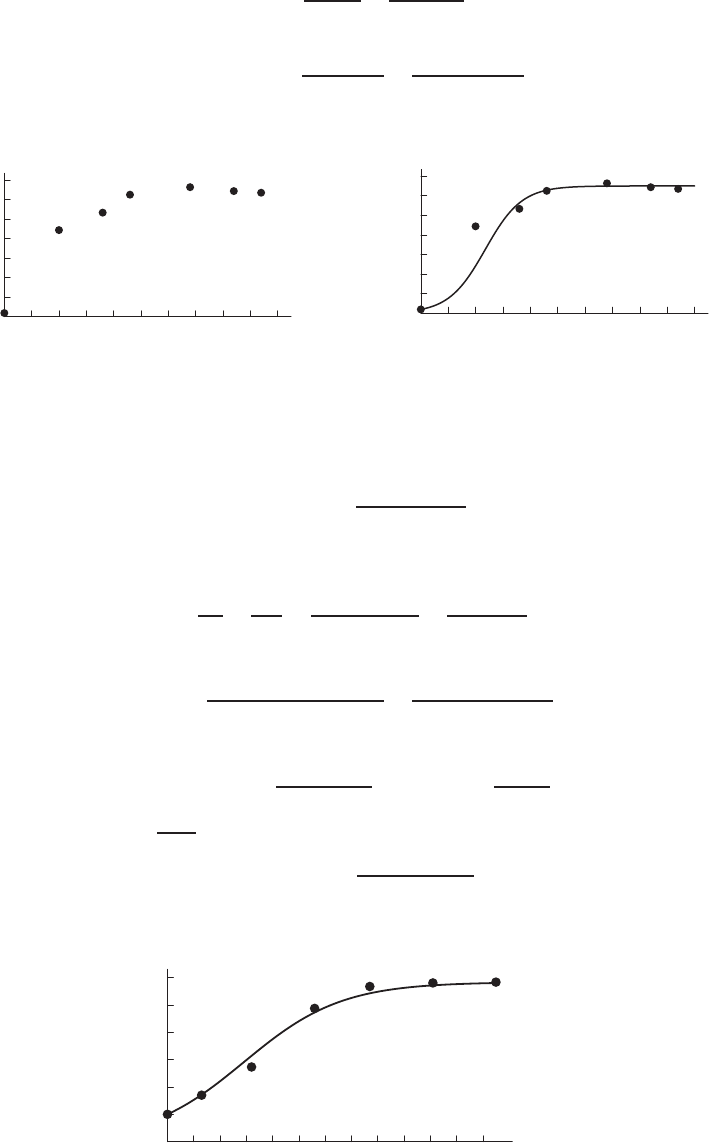
1092 Chapter Eleven /SOLUTIONS
(c) For k= 0.3and L= 13,
A=L−P0
P0
=13 −0.37
0.37 = 34.1.
Putting this into the equation for Pwe get:
P=13
1 + Ae−kt =13
1 + 34.1e−0.3t,
which is plotted in Figure 11.58.
5 10 15 20 25 30 35 40 45 50
2
4
6
8
10
12
14
time (hours)
population
Figure 11.57
5 10 15 20 25 30 35 40 45 50
2
4
6
8
10
12
14
time (hours)
population
Figure 11.58
:P= 13/1 + 34.1e−0.3t
37. (a) The population seems to level off around 5.8, which leads us to believe that the population is growing logistically. If
it were growing exponentially, we would expect the rate of increase to continue increasing with time.
(b) To find k, we solve the logistic equation, dP /dt =kP (1 −P/L), for k:
k=dP/dt
P·(1 −P/L).
We now need to estimate dP/dt and Lfrom the data. The population seems to level off at 5.8, so we take this as as
the carrying capacity, L. We use the first two data points to find dP/dt:
dP
dt ≈∆P
∆t=P(13) −P(0)
13 −0=1.7−1.00
13 = 0.054
Putting in our values for dP/dt,L, and P(13), we get:
k≈dP/dt
P(13) ·(1 −P(13)/L)=0.054
(1.7)(1 −1.7/5.8) = 0.045
(c) The solution curve for dP /dt =kP (1 −P/L)with k= 0.045, and L= 5.8has equation
P=5.8
(1 + Ae−kt)where A=L−P0
P0
.
Since P0= 1 then A=5.8−1
1= 4.8, we have
P=5.8
1 + 4.8e−0.045t
The data and the curve are sketched in Figure 11.59.
10 20 30 40 50 60 70 80 90 100110120
1
2
3
4
5
6
time (hours)
population
Figure 11.59
:P= 5.8/1 + 4.8e−0.045t
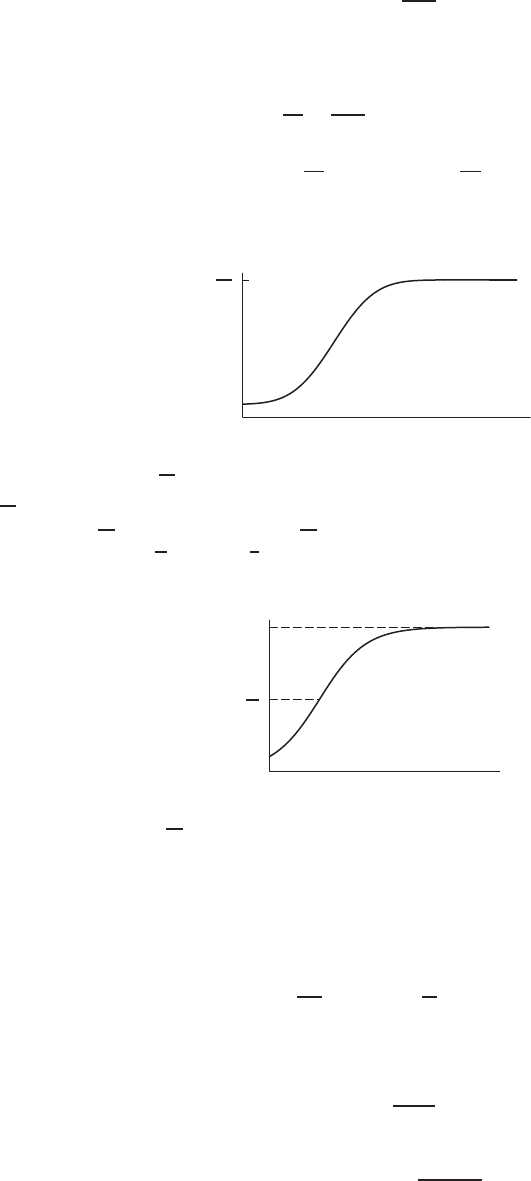
11.7 SOLUTIONS 1093
38. Let Ibe the number of infected people. Then, the number of healthy people in the population is M−I. The rate of
infection is
Infection rate =0.01
M(M−I)I.
and the rate of recovery is
Recovery rate = 0.009I.
Therefore, dI
dt =0.01
M(M−I)I−0.009I
or dI
dt = 0.001I(1 −10 I
M).
This is a logistic differential equation, and so the solution will look like the following graph:
M
10
I
t
The limiting value for Iis1
10 M, so 1/10 of the population is infected in the long run.
39. (a) dp
dt =kp(B−p),where k > 0.
(b) To find when dp
dt is largest, we notice that dp
dt =kp(B−p), as a function of p, is a parabola opening downward with
the maximum at p=B
2,i.e. when 1
2the tin has turned to powder. This is the time when the tin is crumbling fastest.
B
2
B
t
t
(c) If p=0initially, then dp
dt = 0,so we would expect pto remain 0 forever. However, since many organ pipes get tin
pest, we must reconcile the model with reality. There are two possible ideas which solve this problem. First, we could
assume that pis never 0. In other words, we assume that all tin pipes, no matter how new, must contain some small
amount of tin pest. Assuming this means that all organ pipes must deteriorate due to tin pest eventually. Another
explanation is that the powder forms at a slow rate even if there was none present to begin with. Since not all organ
pipes suffer, it is possible that the conversion is catalyzed by some other impurities not present in all pipes.
40. (a) At equilibrium dP/dt = 0, so
dP
dt =kP 1−P
L−cP = 0,
Thus if P6= 0,
kL −kP −cL = 0
P=k−c
kL.
At equilibrium, the annual harvest is
H=cP =c(k−c)
kL.
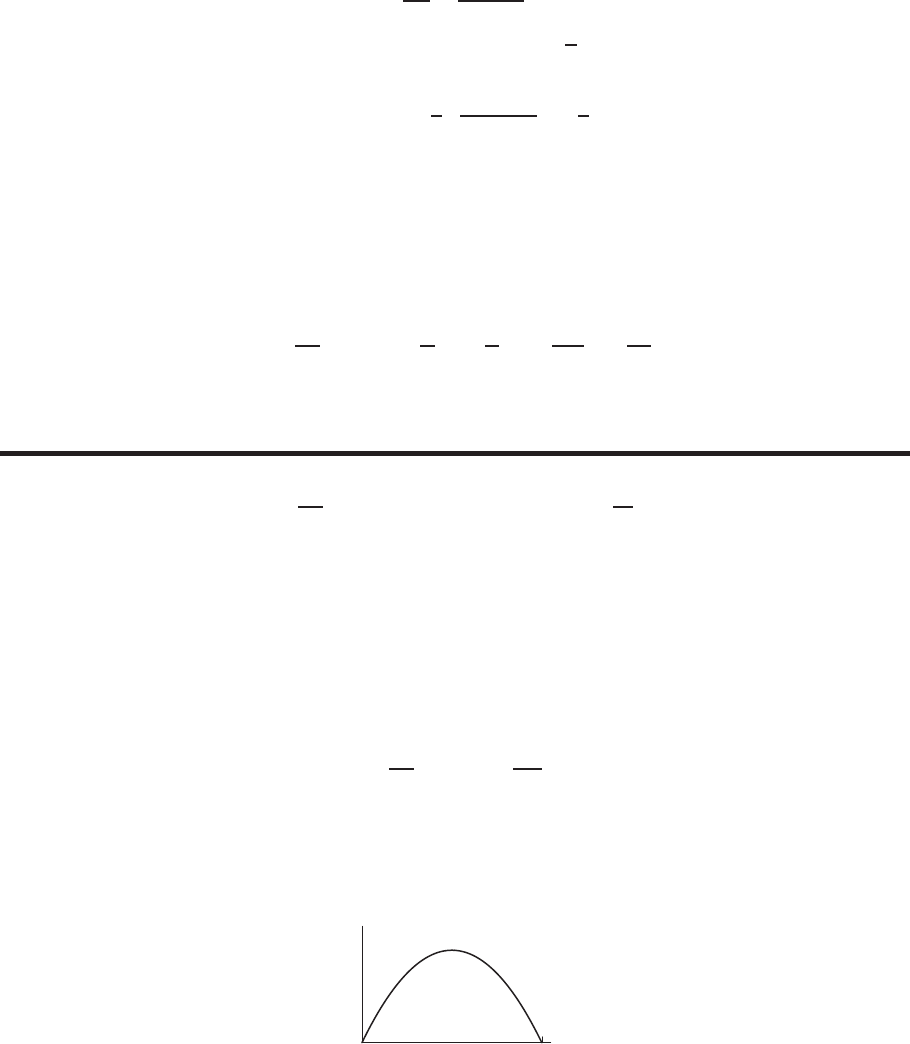
1094 Chapter Eleven /SOLUTIONS
(b) Since kand Lare constant and the annual harvest is H=c(k−c)L/k, at the maximum where dH/dc = 0, we have
dH
dc =(k−2c)
kL= 0
c=k
2.
The maximum value of His then
H=k
2(k−k/2)
kL=k
4L.
(c) The equilibrium population is represented by the P-value (horizontal coordinate) at the point of intersection of the
line and parabola. The annual harvest at the equilibrium, cP , is represented by the vertical coordinate at the point of
intersection.
As cincreases toward k, the slope of the line dP/dt =cP gets steeper and the intersection point between the
line and parabola moves closer to the origin. For c > k/2, the equilibrium population, P= (k−c)L/k, and the
annual harvest, H=c(k−c)L/k, get smaller and smaller. At c=k, the population becomes extinct.
41. The population dies out if His large enough that dP/dt < 0for all P. The largest value for dP/dt =kP (1 −P/L)
occurs when P=L/2; then
dP
dt =kP 1−P
L=kL
21−L/2
L=kL
4.
Thus if H > kL/4, we have dP/dt < 0for all Pand the population dies out if the quota is met.
Strengthen Your Understanding
42. Since dP
dt = 0.08P−0.0032P2= 0.08P1−P
25 ,
we see that when we set dP/dt equal to zero, there are two solutions: one at P= 25 and one at P= 0. There are two
equilibrium solutions, with the second one at P= 0.
43. The maximum rate of change occurs at Q= 25 not at t= 25.
44. The curve has the shape we expect of a logistic curve. However, since the graph is leveling off at a carrying capacity of
100, we expect the inflection point to be at a height of 50, but in the graph the inflection point is above 60.
45. Any quantity that might increase exponentially at first and then eventually level off at a maximum value is a reasonable
answer: for example, the growth of a population in a confined space or sales of a new product with a saturation level.
46. If the maximum rate of change of a logistic function occurs at P= 75, then the carrying capacity is 2·75 = 150. An
answer is in the form dP
dt =kP 1−P
150 ,
where kis any positive constant.
47. Since Qis growing logistically, the graph of dQ/dt against Qis a parabola opening down which passes through the
origin. Since Qhas an equilibrium value at Q= 500, the other horizontal intercept is at Q= 500. See Figure 11.60.
500 Q
dQ/dt
Figure 11.60
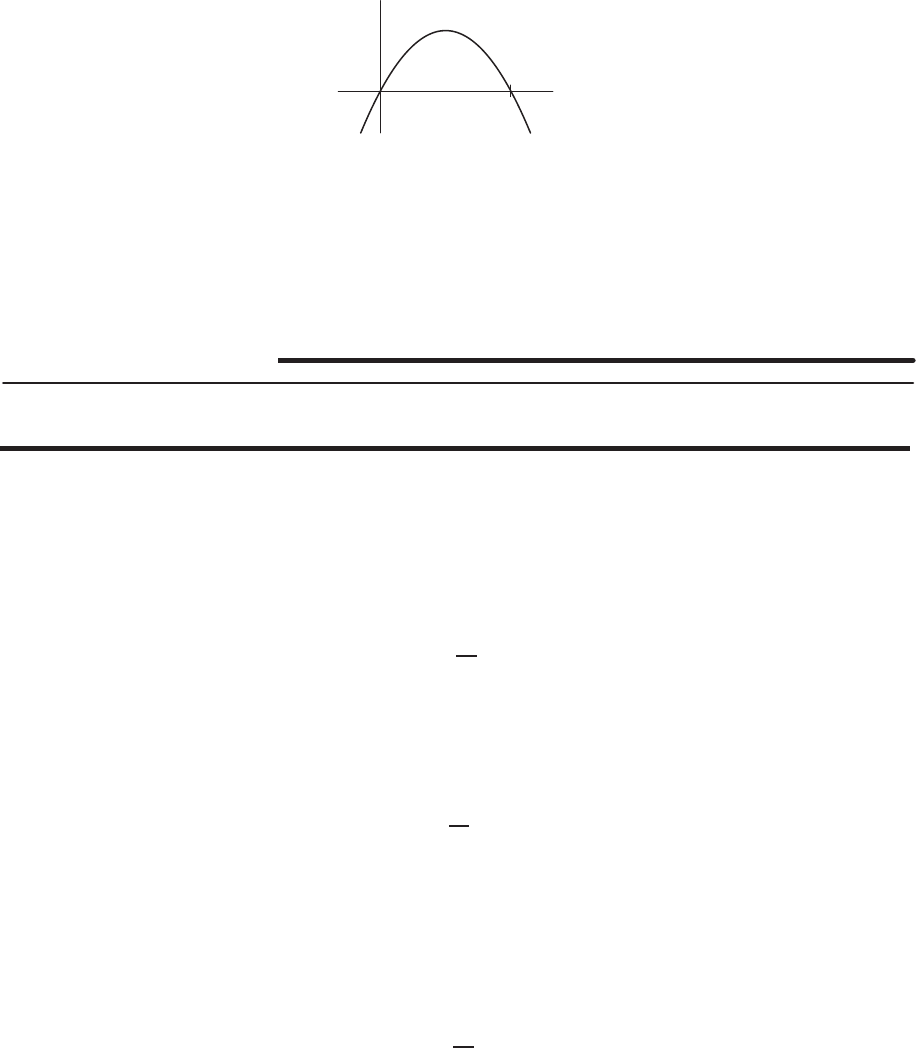
11.8 SOLUTIONS 1095
48. Since Pis growing logistically, the graph of dP/dt against Pis a parabola opening down which passes through the
origin. Since Pincreases when 0< P < 20, we know that dP/dt is positive when 0< P < 20. Since Pdecreases
when P < 0or P > 20, we know that dP/dt is negative for those values of P. See Figure 11.61.
20 P
dP/dt
Figure 11.61
49. False. This is a logistic equation with equilibrium values P= 0 and P= 2. Solution curves do not cross the line P= 2
and do not go from (0,1) to (1,3).
50. True. This is a logistic differential equation. Any solution with P(0) >0tends toward the carrying capacity, L, as t→ ∞.
Solutions for Section 11.8
Exercises
1. Here xand yboth increase at about the same rate.
2. Initially x= 0, so we start with only y. Then ydecreases while xincreases. Then xcontinues to increase while ystarts
to increase as well. Finally ycontinues to increase while xdecreases.
3. xdecreases quickly while yincreases more slowly.
4. The closed trajectory represents populations which oscillate repeatedly.
5. We set each derivative equal to zero and solve:
dx
dt = 0
−3x+xy = 0
x(−3 + y) = 0
x= 0 or y= 3.
Also,
dy
dt = 0
5y−xy = 0
y(5 −x) = 0
y= 0 or x= 5.
Since both derivatives must be zero at an equilibrium point, the equilibrium points are ordered pairs for which x= 0 or
y= 3 and y= 0 or x= 5. The equilibrium points are (0,0) and (5,3).
6. We set each derivative equal to zero and solve:
dx
dt = 0
−2x+ 4xy = 0
x(−2 + 4y) = 0
x= 0 or y= 0.5.

1096 Chapter Eleven /SOLUTIONS
Also,
dy
dt = 0
−8y+ 2xy = 0
y(−8 + 2x) = 0
y= 0 or x= 4.
Since both derivatives must be zero at an equilibrium point, the equilibrium points are ordered pairs for which x= 0 or
y= 0.5and y= 0 or x= 4. The equilibrium points are (0,0) and (4,0.5).
7. We set each derivative equal to zero and solve:
dx
dt = 0
15x−5xy = 0
x(15 −5y) = 0
x= 0 or y= 3.
Also,
dy
dt = 0
10y+ 2xy = 0
y(10 + 2x) = 0
y= 0 or x=−5.
Since both derivatives must be zero at an equilibrium point, the equilibrium points are ordered pairs for which x= 0 or
y= 3 and y= 0 or x=−5. The equilibrium points are (0,0) and (−5,3). (While a negative value might not make
sense if xrepresents the size of a population, it is reasonable in other scenarios in which systems of differential equations
are relevant such as if xrepresents the net worth of a company.)
8. We set each derivative equal to zero and solve:
dx
dt = 0
x2−xy = 0
x(x−y) = 0
x= 0 or y=x.
Also,
dy
dt = 0
15y−3y2= 0
y(15 −3y) = 0
y= 0 or y= 5.
Since both derivatives must be zero at an equilibrium point, the equilibrium points are ordered pairs for which x= 0 or
y=xand y= 0 or y= 5. The equilibrium points are (0,0) and (0,5) and (5,5).
9. (a) At the point x= 3 and y= 2, we have
dx
dt = 5(3) −3(3)(2) = −3<0
dy
dt =−8(2) + (3)(2) = −10 <0,
so both xand yare decreasing.
(b) At the point x= 5 and y= 1, we have
dx
dt = 5(5) −3(5)(1) = 10 >0
dy
dt =−8(1) + (5)(1) = −3<0,
so xis increasing and yis decreasing.
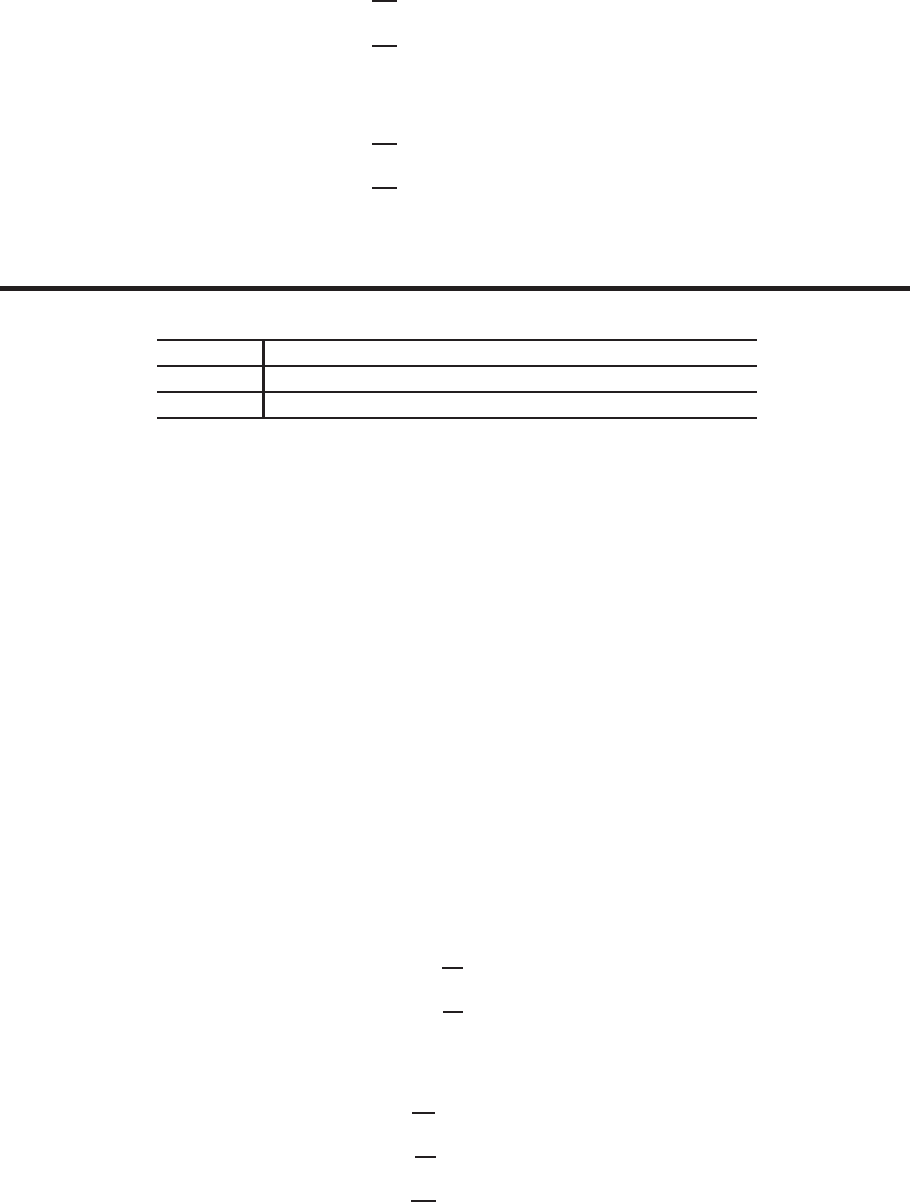
11.8 SOLUTIONS 1097
10. (a) At the point P= 2 and Q= 3, we have
dP
dt = 2(2) −10 = −6<0
dQ
dt = 3 −0.2(2)(3) = 1.8>0,
so Pis decreasing and Qis increasing.
(b) At the point P= 6 and Q= 5, we have
dP
dt = 2(6) −10 = 2 >0
dQ
dt = 5 −0.2(6)(5) = −1<0,
so Pis increasing and Qis decreasing.
Problems
11. (a) The values are given by
Time t(days) 8 12 16 20 22 24 28 32 36 40 44
Susceptibles 1950 1850 1550 1000 750 550 350 250 200 200 200
Infecteds 20 80 240 460 500 460 320 180 100 40 20
(b) The peak of the epidemic is on day 22 when about 500 people are infected.
(c) About 2000 people are susceptible at the onset of the epidemic and only 200 are still susceptible at its end. About
1800 catch the disease and about 200 are spared.
12. (a) On day 20 about 750 are infected.
(b) On day 20 about 2600 are susceptible. Since there are 4000 people in the population, there are 4000 −2600 = 1400
who have already had the disease.
(c) At day 60 the epidemic is over. There are about 400 people who are still susceptible, because they never got the
disease. The rest, 4000 −400 = 3600 caught the disease sometime during the epidemic.
13. (a) The human population shrinks as humans are turned into zombies, so parameter ais negative. The interaction term
for zombies is positive, since an interaction between a human and a zombie increases the zombie population, so cis
positive. The zombie population shrinks by a certain percentage each time interval because some zombies will starve
to death, so bis negative.
(b) The terms aHZ and cHZ both indicate the rate of human to zombie conversions. Since each loss of one human is
directly a gain of one zombie, aHZ =−cHZ. Therefore, the parameter ais exactly the negative of the parameter c.
Thus, a=−c.
14. (a) This is an example of a predator-prey relationship, so this system goes with IV, with xrepresenting the fox population
and yrepresenting the hare population.
(b) This system models the relationship in II, with xrepresenting the tree population and yrepresenting the owl popula-
tion.
(c) This system models the relationship in I with xand ybeing either bees or flowers.
(d) We write a system of differential equations for III with elk and buffalo. In each case, the species would do fine on its
own but is hurt by the other. The terms have signs as follows, with proportionality constants included as desired.
dx
dt =x−xy
dy
dt =y−xy
Notice that xand ycan each represent either the elk or the buffalo population.
15. Since
dS
dt =−aSI,
dI
dt =aSI −bI,
dR
dt =bI
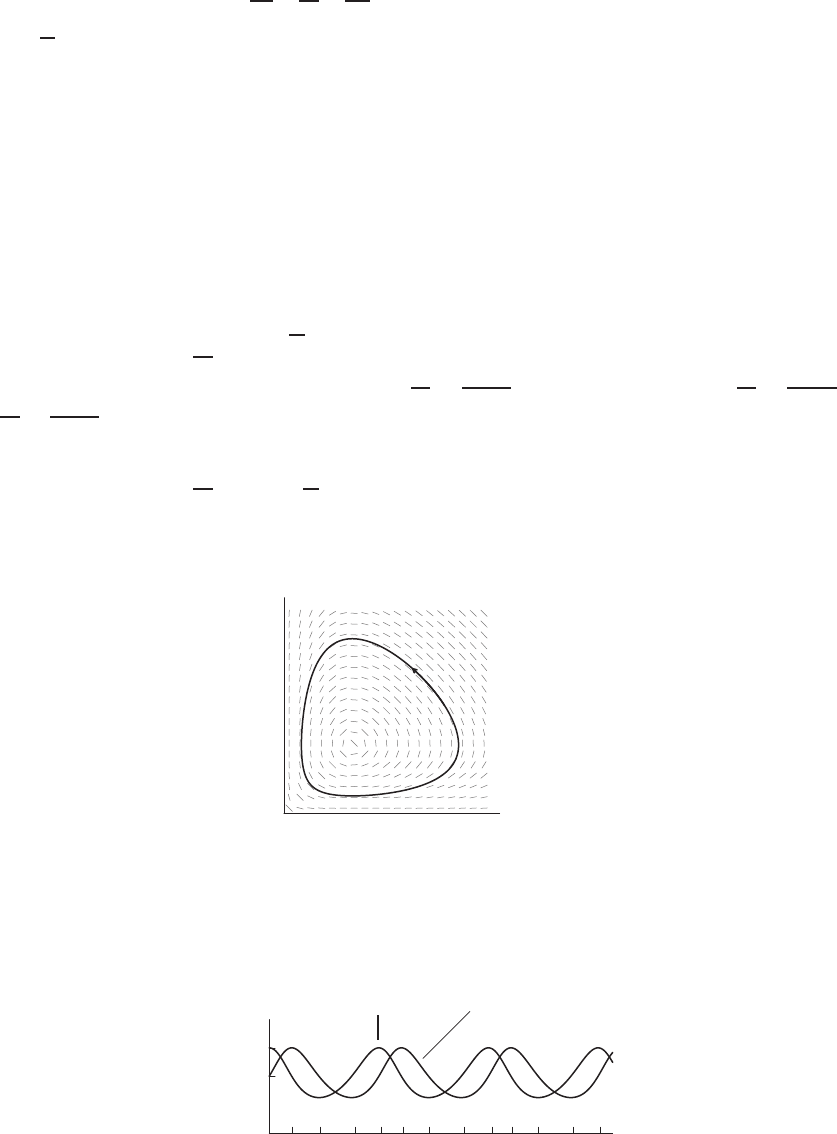
1098 Chapter Eleven /SOLUTIONS
we have dS
dt +dI
dt +dR
dt =−aSI +aSI −bI +bI = 0.
Thus d
dt (S+I+R) = 0, so S+I+R=constant.
16. This is an example of a predator-prey relationship. Normally, we would expect the worm population, in the absence of
predators, to increase without bound. As the number of worms wincreases, so would the rate of increase dw/dt;in other
words, the relation dw/dt =wmight be a reasonable model for the worm population in the absence of predators.
However, since there are predators (robins), dw/dt won’t be that big. We must lessen dw/dt. It makes sense that
the more interaction there is between robins and worms, the more slowly the worms are able to increase their numbers.
Hence we lessen dw/dt by the amount wr to get dw/dt =w−wr. The term −wr reflects the fact that more interactions
between the species means slower reproduction for the worms.
Similarly, we would expect the robin population to decrease in the absence of worms. We’d expect the population
decrease at a rate related to the current population, making dr/dt =−ra reasonable model for the robin population in
absence of worms. The negative term reflects the fact that the greater the population of robins, the more quickly they are
dying off. The wr term in dr/dt =−r+wr reflects the fact that the more interactions between robins and worms, the
greater the tendency for the robins to increase in population.
17. If there are no worms, then w= 0, and dr
dt =−rgiving r=r0e−t, where r0is the initial robin population. If there are
no robins, then r= 0, and dw
dt =wgiving w=w0et, where w0is the initial worm population.
18. There is symmetry across the line r=w. Indeed, since dr
dw =r(w−1)
w(1−r),if we switch wand rwe get dw
dr =w(r−1)
r(1−w),so
dr
dw =r(1−w)
w(r−1) .Since switching wand rchanges nothing, the slope field must be symmetric across the line r=w. The
slope field shows that the solution curves are either spirals or closed curves. Since there is symmetry about the line r=w,
the solutions must in fact be closed curves.
19. If w= 2 and r= 2,then dw
dt =−2and dr
dt = 2,so initially the number of worms decreases and the number of robins
increases. In the long run, however, the populations will oscillate; they will even go back to w= 2 and r= 2.See
Figure 11.62.
1 2 3
1
2
3
w
(worms in millions)
r
(robins in thousands)
(2500 robins)
Figure 11.62
20. Sketching the trajectory through the point (2,2) on the slope field given shows that the maximum robin population is
about 2500, and the minimum robin population is about 500. When the robin population is at its maximum, the worm
population is about 1,000,000.
21.
P0P2P0P2P0P2P0
t
population
✠
Robins
❄
Worms
1
1.5
Figure 11.63

11.8 SOLUTIONS 1099
22. It will work somewhat; the maximum number the robins reach will increase. However, the minimum number the robins
reach will decrease as well. (See graph of slope field.) In the long term, the robin-worm populations will again fall into
a cycle. Notice, however, if the extra robins are added during the part of the cycle where there are the fewest robins, the
new cycle will have smaller variation. See Figure 11.64.
Note that if too many robins are added, the minimum number may get so small the model may fail, since a small
number of robins are more susceptible to disaster.
1 2 3
1
2
3
w
(worms in millions)
r
(robins in thousands)
New trajectory
Old trajectory
✛
✛
Figure 11.64
23. The numbers of robins begins to increase while the number of worms remains approximately constant. See Figure 11.65.
The numbers of robins and worms oscillate periodically between 0.2 and 3, with the robin population lagging behind
the worm population.
1 2 3
1
2
3
w
r
(3,1)
Figure 11.65
24. Estimating from the phase plane, we have
0.18 < r < 3
so the robin population lies between 180 and 3000. Similarly
0.2< w < 3,
so the worm population lies between 200,000 and 3,000,000.
When the robin population is at its minimum r≈0.2, then w≈0.87, so that there are approximately 870,000
worms.
1
3
✠
Worms
✠
Robins
t
P
Figure 11.66

1100 Chapter Eleven /SOLUTIONS
25. (a) Symbiosis, because both populations decrease while alone but are helped by the presence of the other.
(b)
1 2 3 4
1
2
3
4
x
y
Both populations tend to infinity or both tend to zero.
26. (a) Competition, because both populations grow logistically when alone, but are harmed by the presence of the other.
(b) See Figure 11.67. In the long run, x→2,y→0. In other words, ybecomes extinct.
1 2 3 4
1
2
3
4
x
y
Figure 11.67
27. (a) Predator-prey, because xdecreases while alone, but is helped by y, whereas yincreases logistically when alone, and
is harmed by x. Thus xis predator, yis prey.
(b) See Figure 11.68. Provided neither initial population is zero, both populations tend to about 1. If xis initially zero,
but yis not, then y→ ∞. If yis initially zero, but xis not, then x→0.
1 2 3 4
1
2
3
4
x
y
Figure 11.68
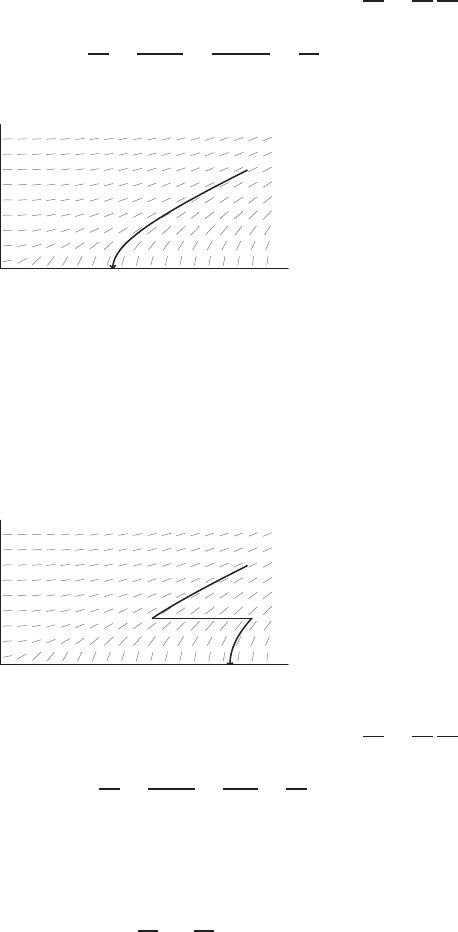
11.8 SOLUTIONS 1101
28. (a) Thinking of yas a function of xand xas a function of t, then by the chain rule: dy
dt =dy
dx
dx
dt , so:
dy
dx =dy/dt
dx/dt =−0.01x
−0.05y=x
5y
10 20 30 40 50 60
10
20
30
x
(thousand US troops)
y
(thousand Japanese troops)
(b) The figure above shows the slope field for this differential equation and the trajectory starting at x0= 54, y0= 21.5.
The trajectory goes to the x-axis, where y= 0, meaning that the Japanese troops were all killed or wounded before
the US troops were, and thus predicts the US victory (which did occur). Since the trajectory meets the x-axis at
x≈25, the differential equation predicts that about 25,000 US troops would survive the battle.
(c) The fact that the US got reinforcements, while the Japanese did not, does not alter the predicted outcome (a US
victory). The US reinforcements have the effect of changing the trajectory, altering the number of troops surviving
the battle. See the graph below.
10 20 30 40 50 60
10
20
30
x
(thousand US troops)
y
(thousand Japanese troops)
29. (a) Thinking of yas a function of xand xas a function of t, then by the chain rule: dy
dt =dy
dx
dx
dt , so:
dy
dx =dy/dt
dx/dt =−bx
−ay =bx
ay
(b) Separating variables,
Zay dy =Zbx dx
ay2
2=bx2
2+k
ay2−bx2=Cwhere C= 2k
30. (a) Lanchester’s square law for the battle of Iwo Jima is
0.05y2−0.01x2=C.
If we measure xand yin thousands, x0= 54 and y0= 21.5, so 0.05(21.5)2−0.01(54)2=Cgiving C=−6.0475.
Thus the equation of the trajectory is
0.05y2−0.01x2=−6.0475
giving
x2−5y2= 604.75.
(b) Assuming that the battle did not end until all the Japanese were dead or wounded, that is, y= 0, then the number
of US soldiers remaining is given by x2−5(0)2= 604.75. This gives x= 24.59, or about 25,000 troops. This is
approximately what happened.
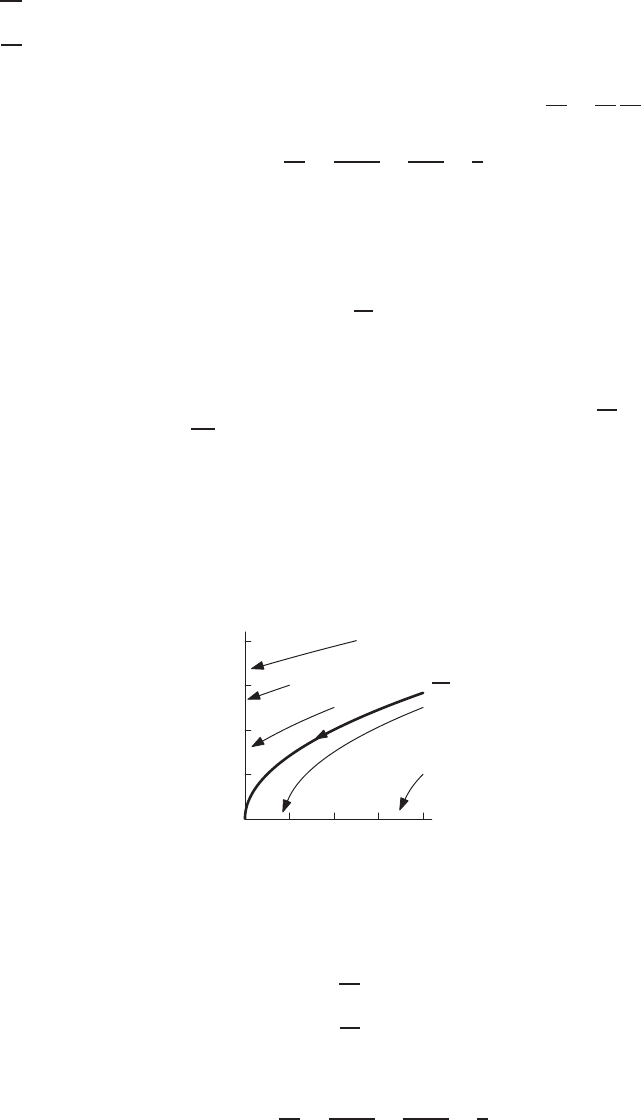
1102 Chapter Eleven /SOLUTIONS
31. (a) Since the guerrillas are hard to find, the rate at which they are put out of action is proportional to the number of chance
encounters between a guerrilla and a conventional soldier, which is in turn proportional to the number of guerrillas
and to the number of conventional soldiers. Thus the rate at which guerrillas are put out of action is proportional to
the product of the strengths of the two armies.
(b) dx
dt =−xy
dy
dt =−x.
(c) Thinking of yas a function of xand xa function of of t, then by the chain rule: dy
dt =dy
dx
dx
dt so:
dy
dx =dy/dt
dx/dt =−x
−xy =1
y.
Separating variables:
Zy dy =Zdx
y2
2=x+C.
The value of Cis determined by the initial strengths of the two armies. Note that Ccould be written on the opposite
side of the equation, giving it the opposite sign.
(d) The sign of Cdetermines which side wins the battle. Looking at the general solution y2
2=x+C, we see that if
C > 0the y-intercept is at √2C, so ywins the battle by virtue of the fact that it still has troops when x= 0. If
C < 0then the curve intersects the axes at x=−C, so xwins the battle because it has troops when y= 0. If C= 0,
then the solution goes to the point (0,0), which represents the case of mutual annihilation.
(e) We assume that an army wins if the opposing force goes to 0first. Figure 11.69 shows that in our formulation, the
conventional force wins if C > 0and the guerrillas win if C < 0. Neither side wins if C= 0 (all soldiers on both
sides are killed in this case).
1 2 3 4
1
2
3
4
x
(guerrilla)
y
(conventional)
C > 0
conventional wins
y2
2=x
(i.e.
C= 0
)
C < 0
guerrilla wins
Figure 11.69
32. (a) Taking the constants of proportionality to be aand b, with a > 0and b > 0, the equations are
dx
dt =−axy
dy
dt =−bxy.
(b) Thinking of xand yas functions of t, then by the chain rule:
dy
dx =dy/dt
dx/dt =−bxy
−axy =b
a.
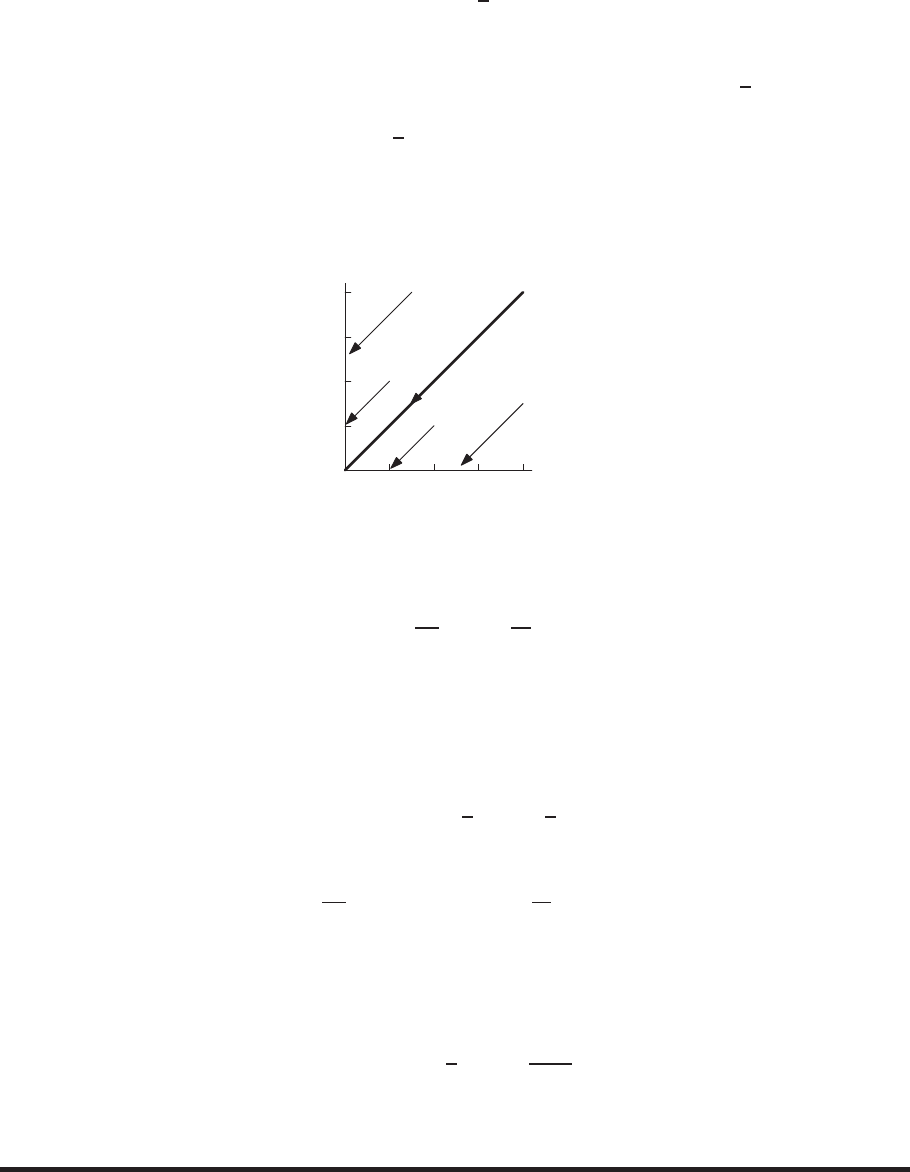
11.8 SOLUTIONS 1103
Solving the differential equation gives
y=b
ax+C,
where Cdepends on the initial sizes of the two armies. Note that Ccould be written on the opposite side of the
equation, giving it the opposite sign.
(c) The sign of Cdetermines which side wins the battle. Looking at the general solution y=b
ax+C, we see that if
C > 0the y-intercept is at C, so ywins the battle by virtue of the fact that it still has troops when x= 0. If C < 0
then the curve intersects the axes at x=−a
bC, so xwins the battle because it has troops when y= 0. If C= 0,
then the solution goes to the point (0,0), which represents the case of mutual annihilation.
(d) We assume that an army wins if the opposing force goes to 0first. Figure 11.70 shows that in our formulation, ywins
if C > 0and xwins if C < 0.
1 2 3 4
1
2
3
4
x
(guerrilla)
y
(guerrilla)
C > 0
y
wins
C < 0
x
wins
y=bx/a
(i.e.
C= 0
)
Figure 11.70
33. (a) At an equilibrium point both wand rare constant, so
dw
dt = 0 and dr
dt = 0.
Therefore, we need to solve
aw −cwr = 0 and −br +kwr = 0.
Rearranging gives
w(a−cr) = 0 and −r(b−kw) = 0
so the only equilibrium points are w= 0, r = 0 and
w=b
kand r=a
c.
(b) If the insecticide causes a decline in the number of worms then the model becomes
dw
dt =aw −cwr −pw and dr
dt =−br +kwr
where pis a positive constant. Solving as before,
w(a−p−cr) = 0 and −r(b−kw) = 0,
so the equilibrium points are w= 0, r = 0 and
w=b
kand r=a−p
c.
So, the equilibrium worm population is unchanged but the equilibrium robin population falls.
Strengthen Your Understanding
34. It is possible for dx/dt and dy/dt to be positive simultaneously. For example, if x=y= 1, then dx/dt = 2.6and
dy/dt = 3.5, meaning that both xand yare increasing.

1104 Chapter Eleven /SOLUTIONS
35. Using the chain rule, we know that
dy
dx =dy/dt
dx/dt .
Thus, if dx/dt < 0and dy/dt > 0, we must have dy/dx < 0.
36. Since Xis indifferent to Yand thrives on its own, we have dx/dt =kx with kpositive. Since Yneeds Xto survive, we
have dy/dt =−k1y+k2xy, with k1and k2positive. One possible example is
dx
dt = 0.5x
dy
dt =−0.1y+ 0.3xy.
37. We have dx/dt =k1x−k2xy with k1and k2positive. Similarly for dy/dt. One possible example is
dx
dt = 0.5x−0.2xy
dy
dt = 0.1y−0.3xy.
38. The parameter ais larger if a disease is more contagious, so we pick a very contagious disease for D1and a disease that
is not very contagious for D2. The flu is spread easily through such things as sneezing, whereas a disease such as HIV
requires something like an exchange of bodily fluids, so we might pick a flu for D1and HIV for D2.
39. True. Specifying x(0) and y(0) corresponds to picking a starting point in the plane and thereby picking the unique solution
curve through that point.
40. False. Competitive exclusion, in which one population drives out another, is modeled by a system of differential equations.
Solutions for Section 11.9
Exercises
1. Equilibrium points occur where both derivatives dx/dt and dy/dt are zero. Thus, equilibrium are located at the intersec-
tion of a nullcline with vertical line segments and a nullcline with horizontal line segments. We see in Figure 11.71 there
is only one equilibrium point located at the point (4,10).
2 4 6
5
10
15
x
y
Figure 11.71
2. (a) Since the point (4,7) is in Region I, dx/dt < 0and dy/dt > 0.
(b) Since the point (4,10) is an equilibrium point, dx/dt = 0 and dy/dt = 0.
(c) Since the point (6,15) is in Region II, dx/dt < 0and dy/dt < 0.

11.9 SOLUTIONS 1105
3. Since (2,5) is in Region IV, dx/dt > 0and dy/dt > 0. Thus, the trajectory goes up and to the right toward the
equilibrium (4,10). See Figure 11.72.
2 4 6
5
10
15
x
y
Figure 11.72
4. Since dx/dt > 0and dy/dt < 0in Region III, a trajectory that starts at (2,10) goes down and to the right toward the
equilibrium (4,10) located at the intersection of the nullclines. See Figure 11.73.
2 4 6
5
10
15
x
y
Figure 11.73
5. We can see in Figure 11.89 that any trajectory eventually tends toward the equilibrium point (4,10).
6. Equilibrium points occur where both derivatives dx/dt and dy/dt are zero. Thus, equilibrium are located at the intersec-
tion of a nullcline with vertical line segments and a nullcline with horizontal line segments. We see in Figure 11.71 there
are three equilibrium points located at (0,0),(0,6), and approximately (13,0).
5 10 15
2
4
6
x
y
Figure 11.74

1106 Chapter Eleven /SOLUTIONS
7. (a) The point (5,2) has dx/dt > 0and dy/dt > 0.
(b) The point (10,2) has dx/dt < 0. Since the point (10,2) is on a nullcline horizontal line segments, dy/dt = 0.
(c) The point (10,1) has dy/dt > 0. Since the point (10,1) is on a nullcline with vertical line segments, dx/dt = 0.
8. At the point (2,5),dx/dt < 0and dy/dt > 0. The trajectory goes up and to the left, tending toward the equilibrium
point (0,6). See Figure 11.75.
5 10 15
2
4
6
x
y
Figure 11.75
9. At the point (10,4), we have dx/dt < 0and dy/dt < 0. The trajectory goes down and to the left, crossing the top
nullcline with dy/dt = 0. The trajectory then goes up and to the left since dy/dt has changed from negative to positive.
The trajectory eventually tends toward the equilibrium point (0,6). See Figure 11.76.
5 10 15
2
4
6
x
y
Figure 11.76
10. Any trajectory eventually tends toward the equilibrium point (0,6).
11. On the phase plane, it appears that slopes are vertical along the lines y= 3 and x= 0 (the y-axis) and that the slopes are
horizontal along the lines x= 5 and y= 0 (the x-axis). See Figure 11.77.
5
3
x
y
Figure 11.77
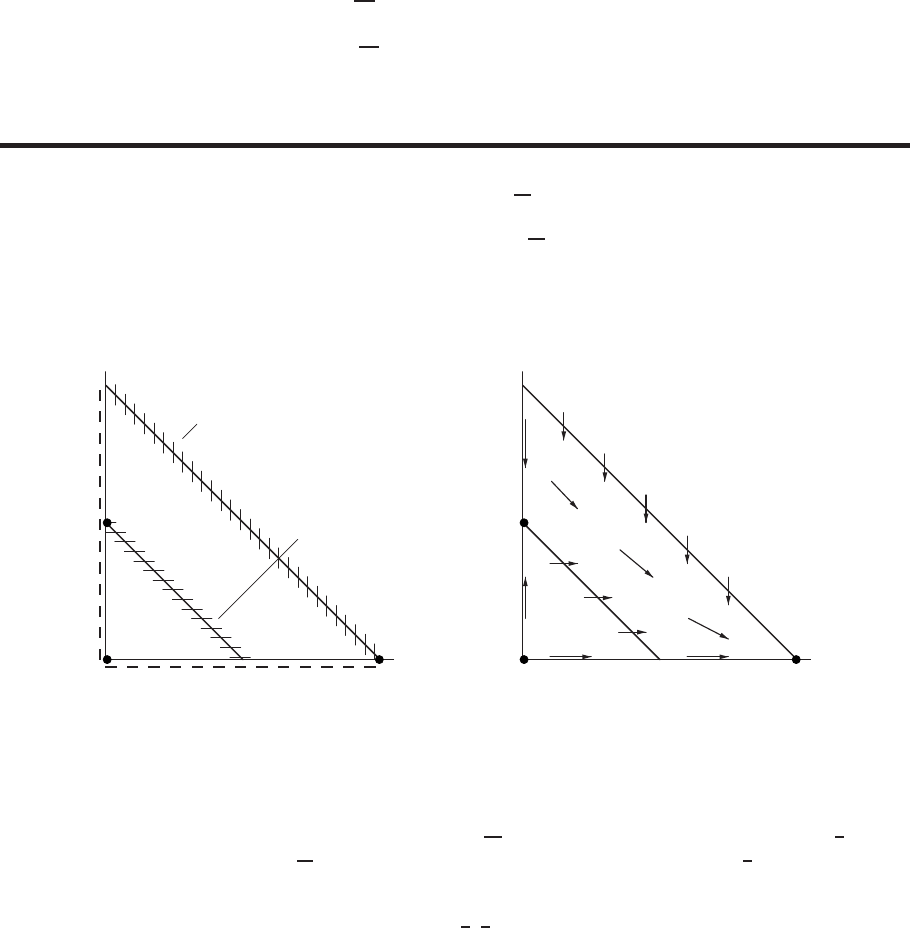
11.9 SOLUTIONS 1107
12. (a) To find the equilibrium points we set
20x−10xy = 0
25y−5xy = 0.
So, x= 0,y= 0 is an equilibrium point. Another one is given by
10y= 20
5x= 25.
Therefore, x= 5,y= 2 is the other equilibrium point.
(b) At x= 2,y= 4,
dx
dt = 20x−10xy = 40 −80 = −40
dy
dt = 25y−5xy = 100 −40 = 60.
Since these are not both zero, this point is not an equilibrium point.
Problems
13. We first find the nullclines. Again, we assume x, y ≥0.
Vertical nullclines occur where dx/dt = 0, which happens when dx
dt =x(2 −x−y) = 0,
i.e. when x= 0 or x+y= 2.
Horizontal nullclines occur where dy/dt = 0, which happens when dy
dt =y(1−x−y) = 0, i.e. when y= 0 or x+y= 1.
These nullclines are shown in Figure 11.78.
Equilibrium points (also shown in Figure 11.78) occur where both dy/dt and dx/dt are 0, i.e. at the intersections of
vertical and horizontal nullclines. There are three such points for these equations: (0,0),(0,1), and (2,0).
1 2
1
2
x
y
✠
x+y= 1
dy/dt = 0
✠
x+y= 2
dx/dt = 0
Figure 11.78
: Nullclines and equilibrium points
(dots)
1 2
1
2
x
y
(I)
(II)
(III)
Figure 11.79
: General directions of trajectories
and equilibrium points (dots)
Looking at sectors in Figure 11.79, we see that no matter in what sector the initial point lies, the trajectory will head
toward the equilibrium point (2,0).
14. We first find the nullclines. Vertical nullclines occur where dx
dt = 0, which happens when x= 0 or y=1
3(2 −x).
Horizontal nullclines occur where dy
dt =y(1 −2x) = 0, which happens when y= 0 or x=1
2. These nullclines are
shown in Figure 11.80.
Equilibrium points (also shown in Figure 11.80) occur at the intersections of vertical and horizontal nullclines. There
are three such points for this system of equations; (0,0),(1
2,1
2)and (2,0).
The nullclines divide the positive quadrant into four regions as shown in Figure 11.80. Trajectory directions for these
regions are shown in Figure 11.81.
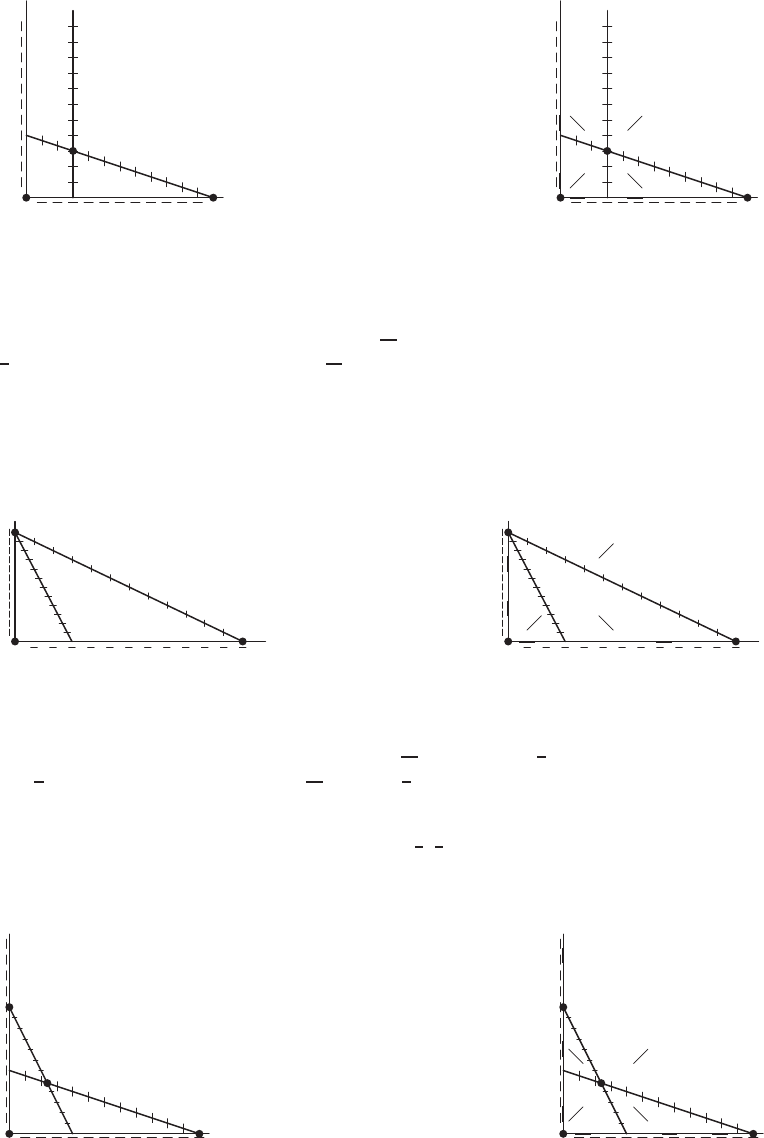
1108 Chapter Eleven /SOLUTIONS
2
1/2
2/3
y
x
III
III IV
Figure 11.80
: Nullclines and
equilibrium points (dots)
2
1/2
2/3
y
x
✠
■
✒❘
✲ ✲
✻
✻
Figure 11.81
: General directions of
trajectories and equilibrium points
(dots)
15. We first find nullclines. Vertical nullclines occur where dx
dt =x(2 −x−2y) = 0, which happens when x= 0 or
y=1
2(2 −x). Horizontal nullclines occur where dy
dt =y(1 −2x−y) = 0, which happens when y= 0 or y= 1 −2x.
These nullclines are shown in Figure 11.82.
Equilibrium points (also shown in the figure below) occur at the intersections of vertical and horizontal nullclines.
There are three such points for this system; (0,0),(0,1), and (2,0).
The nullclines divide the positive quadrant into three regions as shown in the figure below. Trajectory directions for
these regions are shown in Figure 11.83.
0.5 2
1
I II
III
Figure 11.82
: Nullclines and equilibrium
points (dots)
0.5 2
1
✒❘
✠
✲ ✲
✻
✻
x
y
Figure 11.83
: General directions of
trajectories and equilibrium points (dots)
16. We first find the nullclines. Vertical nullclines occur where dx
dt =x(1 −y−x
3) = 0, which happens when x= 0 or
y= 1 −x
3. Horizontal nullclines occur where dy
dt =y(1 −y
2−x) = 0, which happens when y= 0 or y= 2(1 −x).
These nullclines are shown in Figure 11.84.
Equilibrium points (also shown in Figure 11.84) occur at the intersections of vertical and horizontal nullclines. There
are four such points for this system: (0,0),(0,2),(3,0), and (3
5,4
5).
The nullclines divide the positive quadrant into four regions as shown in Figure 11.84. Trajectory directions for these
regions are shown in Figure 11.85.
1 3
1
2
x
y
III
I II
IV
Figure 11.84
: Nullclines and
equilibrium points (dots)
1 3
1
2
x
y
✒❘
❘ ✠
✲ ✲ ✲
✻
✻
❄
Figure 11.85
: General directions
of trajectories and equilibrium
points (dots)
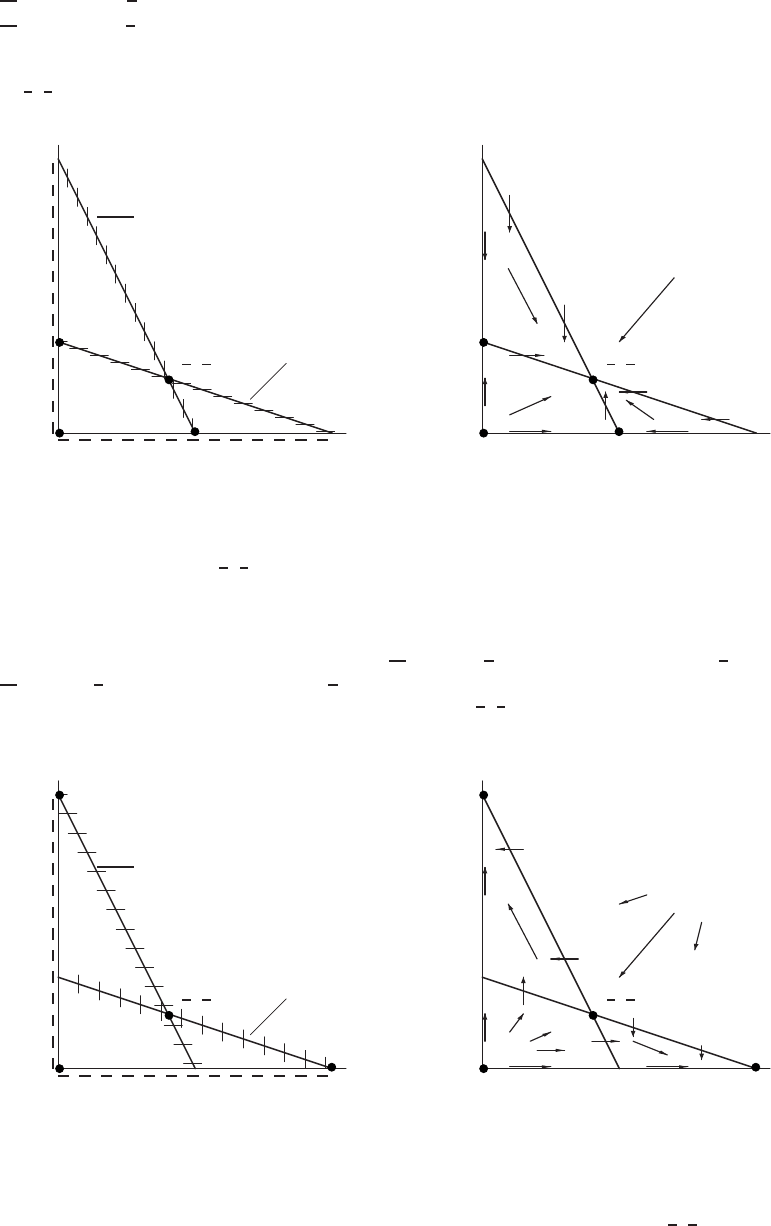
11.9 SOLUTIONS 1109
17. We first find the nullclines. Again, we assume x, y ≥0.
dx
dt =x(1 −x−y
3) = 0 when x= 0 or x+y/3 = 1.
dy
dt =y(1 −y−x
2) = 0 when y= 0 or y+x/2 = 1.
These nullclines are shown in Figure 11.86. There are four equilibrium points for these equations. Three of them are the
points, (0,0),(0,1), and (1,0). The fourth is the intersection of the two lines x+y/3 = 1 and y+x/2 = 1. This point
is (4
5,3
5).
1 2
1
3
x
y
✛x+y/3 = 1
dx/dt = 0
✠
y+x/2 = 1
dy/dt = 0
(4
5,3
5)
Figure 11.86
: Nullclines and equilibrium points
(dots)
1 2
1
3
x
y
(I)
(IV)
(III)
(II)
(4
5,3
5)
Figure 11.87
: General directions of trajectories
and equilibrium points (dots)
Looking at sectors in Figure 11.87, we see that no matter in what sector the initial point lies, the trajectory will head
toward the equilibrium point (4
5,3
5). Only if the initial point lies on the x- or y-axis, will the trajectory head toward the
equilibrium points at (1,0),(0,1), or (0,0). In fact, the trajectory will go to (0,0) only if it starts there, in which case
x(t) = y(t) = 0 for all t. From direction of the trajectories in Figure 11.87, it appears that if the initial point is in sectors
(I) or (III), then it will remain in that sector as it heads toward the equilibrium.
18. We assume that x, y ≥0and then find the nullclines. dx
dt =x(1 −x
2−y) = 0 when x= 0 or y+x
2= 1.
dy
dt =y(1 −y
3−x) = 0 when y= 0 or x+y
3= 1.
We find the equilibrium points. They are (2,0),(0,3),(0,0), and (4
5,3
5). The nullclines and equilibrium points are shown
in Figure 11.88.
1 2
1
3
x
y
✛x+y/3 = 1
dy/dt = 0
✠
y= 1 −x/2
dx/dt = 0
(4
5,3
5)
Figure 11.88
: Nullclines and equilibrium points
(dots)
1 2
1
3
x
y
(I)
(IV) (III)
(II)
(4
5,3
5)
Figure 11.89
: General directions of trajectories
and equilibrium points (dots)
Figure 11.89 shows that if the initial point is in sector (I), the trajectory heads toward the equilibrium point (0,3).
Similarly, if the trajectory begins in sector (III), then it heads toward the equilibrium (2,0) over time. If the trajectory
begins in sector (II) or (IV), it can go to any of the three equilibrium points (2,0),(0,3), or (4
5,3
5).
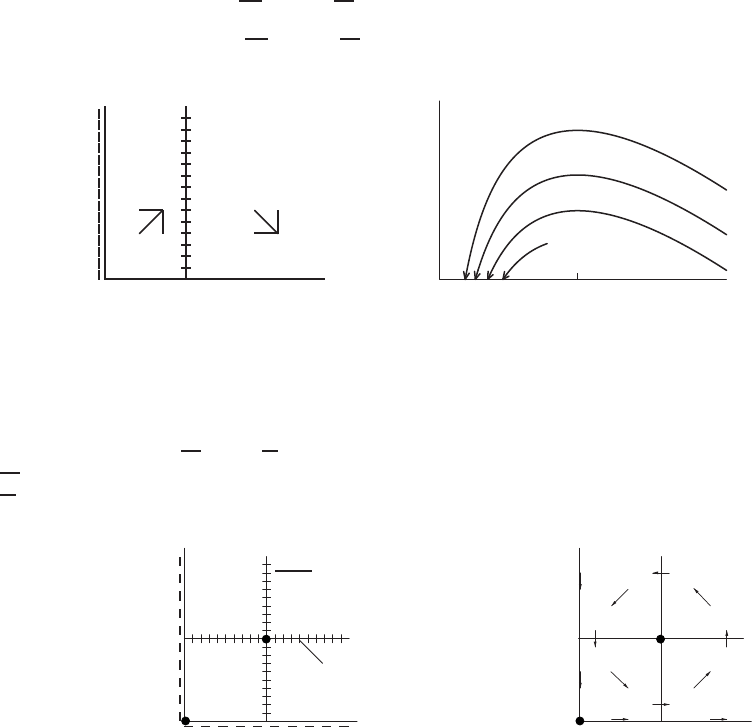
1110 Chapter Eleven /SOLUTIONS
19. (a) dS/dt = 0 where S= 0 or I= 0 (both axes).
dI/dt = 0.0026I(S−192), so dI/dt = 0 where I= 0 or S= 192.
Thus every point on the Saxis is an equilibrium point (corresponding to no one being sick).
(b) In region I, where S > 192,dS
dt <0and dI
dt >0.
In region II, where S < 192,dS
dt <0and dI
dt <0. See Figure 11.90.
I
S
II I
✛
✠❄✛
■✻
192
Figure 11.90
192 S
I
Figure 11.91
(c) If the trajectory starts with S0>192, then Iincreases to a maximum when S= 192. If S0<192, then Ialways
decreases. See Figure 11.90. Regardless of the initial conditions, the trajectory always goes to a point on the S-axis
(where I= 0). The S-intercept represents the number of students who never get the disease. See Figure 11.91.
20. The nullclines are where dw
dt = 0 or dr
dt = 0.
dw
dt = 0 when w−wr = 0, so w(1 −r) = 0 giving w= 0 or r= 1.
dr
dt = 0 when −r+rw = 0, so r(w−1) = 0 giving r= 0 or w= 1.
1
1
w
r
✛w= 1
dr/dt = 0
■
r= 1
dw/dt = 0
Figure 11.92
: Nullclines and equilibrium points (dots)
1
1
w
r
(I)
(II) (III)
(IV)
Figure 11.93
The equilibrium points are where the nullclines intersect: (0,0) and (1,1). The nullclines split the first quadrant into
four sectors. See Figure 11.92. We can get a feel for how the populations interact by seeing the direction of the trajectories
in each sector. See Figure 11.93. If the populations reach an equilibrium point, they will stay there. If the worm population
dies out, the robin population will also die out, too. However, if the robin population dies out, the worm population will
continue to grow.
Otherwise, it seems that the populations cycle around the equilibrium (1,1). The trajectory moves from sector to
sector: trajectories in sector (I) move to sector (II); trajectories in sector (II) move to sector (III); trajectories in sector
(III) move to sector (IV); trajectories in sector (IV) move back to sector (I). The robins keep the worm population down
by feeding on them, but the robins need the worms (as food) to sustain the population. These conflicting needs keep the
populations moving in a cycle around the equilibrium.
21. (a) If Bwere not present, then we’d have A′= 2A, so company A’s net worth would grow exponentially. Similarly,
if Awere not present, Bwould grow exponentially. The two companies restrain each other’s growth, probably by
competing for the market.
(b) To find equilibrium points, find the solutions of the pair of equations
A′= 2A−AB = 0
B′=B−AB = 0
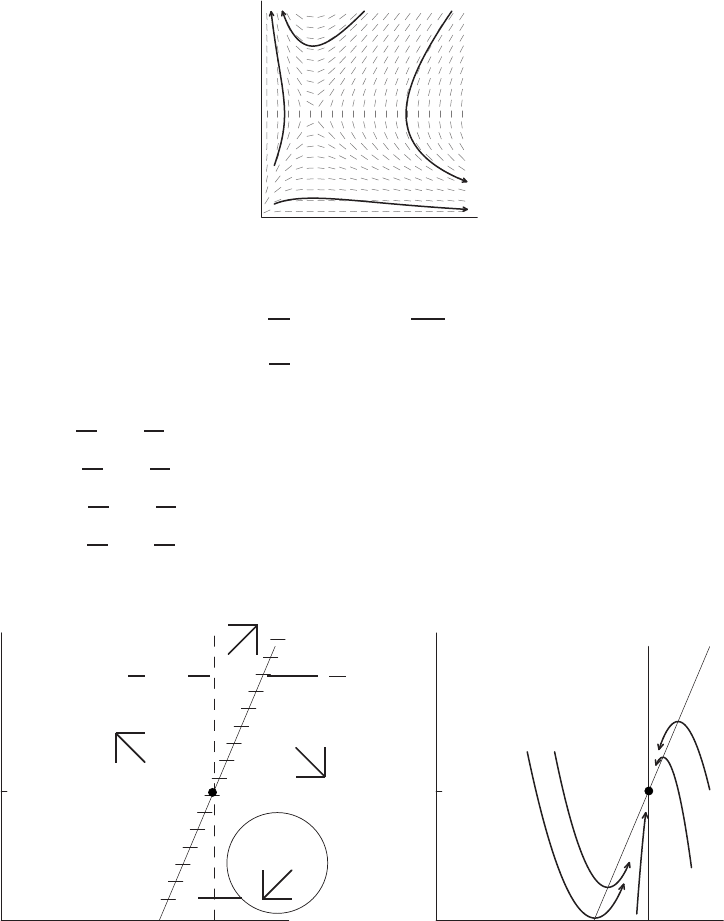
11.9 SOLUTIONS 1111
The first equation has solutions A= 0 or B= 2.The second has solutions B= 0 or A= 1.Thus the equilibrium
points are (0,0) and (1,2).
(c) In the long run, one of the companies will go out of business. Two of the trajectories in the figure below go toward the
Aaxis; they represent Asurviving and Bgoing out of business. The trajectories going toward the Baxis represent
Agoing out of business. Notice both the equilibrium points are unstable.
1 2 3 4
1
2
3
4
A
B
22. (a) See Figure 11.94.
dx
dt = 0 when x=10.5
0.45 = 23.3
dy
dt = 0 when 8.2x−0.8y−142 = 0
There is an equilibrium point where the trajectories cross at x= 23.3,y= 61.7
In region I, dx
dt >0,dy
dt <0.
In region II, dx
dt <0,dy
dt <0.
In region III, dx
dt <0,dy
dt >0.
In region IV, dx
dt >0,dy
dt >0.
(b) See Figure 11.95.
23.3
61.7
x
(Soviet)
y
(US)
Region I
❘
✲
❄
Region II
✠
✛
❄
Region III
■
✛✻
Region IV
✒
✲
✻
✛
dx
dt = 0 ✲dy
dt = 0
✛
Figure 11.94
: Nullclines and equilibrium point (dot) for
US-Soviet arms race
23.3
61.7
x
(Soviet)
y
(US)
Figure 11.95
: Trajectories for US-Soviet arms race.
(c) All the trajectories tend toward the equilibrium point x= 23.3,y= 61.7. Thus the model predicts that in the long-
run the arms race will level off with the Soviet Union spending 23.3 billion dollars a year on arms and the US 61.7
billion dollars.
(d) As the model predicts, yearly arms expenditure did tend toward 23 billion for the Soviet Union and 62 billion for the
US.
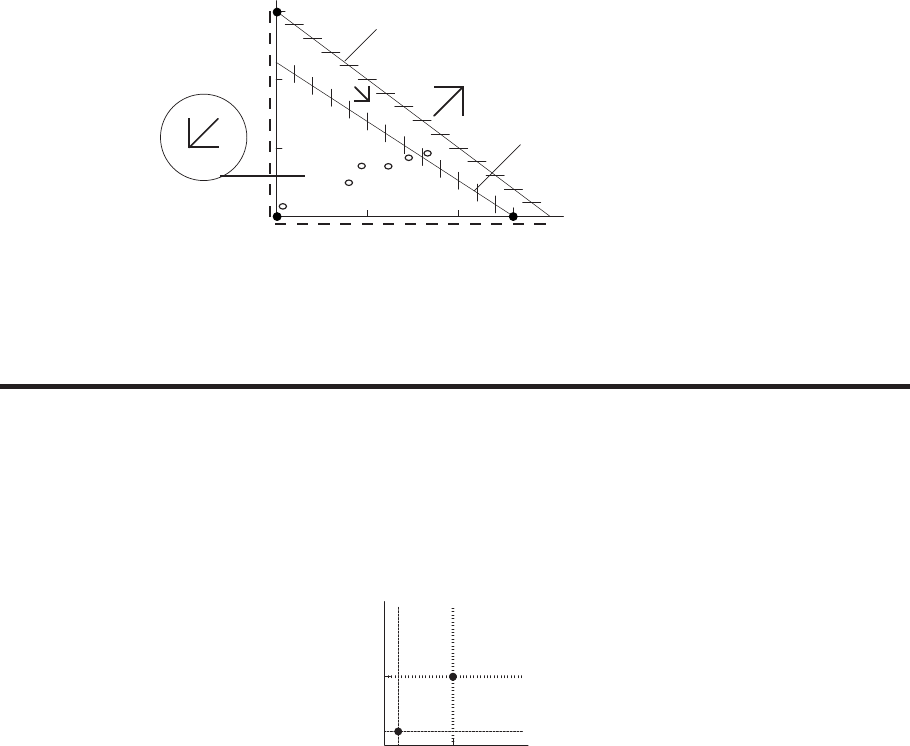
1112 Chapter Eleven /SOLUTIONS
23. (a) The nullclines are P= 0 or P1+3P2= 13 (where dP1/dt = 0) and P= 0 or P2+0.4P1= 6 (where dP2/dt = 0).
(b) The phase plane in Figure 11.96 shows that P2will eventually exclude P1regardless of where the experiment starts
so long as there were some P2originally. Consequently, the data points would have followed a trajectory that starts
at the origin, crosses the first nullcline and goes left and upward between the two nullclines to the point P1= 0,
P2= 6.
5 10 15
2
4
6
P1
P2
✒
✲
✻✠
✛
❄
■
✛
✻
P2+ 0.4P1= 6
dP2/dt =0
✠
P1+ 3P2= 13
dP1/dt = 0
✠
✲
Figure 11.96
: Nullclines and equilibrium points (dots) for
Gause’s yeast data (hollow dots)
Strengthen Your Understanding
24. The trajectory has no arrow to indicate direction.
25. Equilibrium occurs when both dx/dt = 0 and dy/dt = 0. Both nullclines have horizontal line segments indicating
points that dy/dt = 0. There are no nullclines that indicate where dx/dt = 0. Thus, the point (6,6) has dy/dt = 0 but
dx/dt 6= 0 and is not an equilibrium point.
26. An equilibrium point is a point where a nullcline with vertical trajectories intersects a nullcline with horizontal trajectories.
There are many possible ways to draw this graph. One example is shown in Figure 11.97.
1
1
x
y
Figure 11.97
27. Nullclines show where trajectories are vertical or horizontal. We see that the trajectory shown is vertical at approximately
the points (0.4,1) and (2.1,1) so it is reasonable to draw a nullcline showing vertical trajectories on the line y= 1.
The trajectory shown is horizontal at approximately the points (1,2.1) and (1,0.4) so it is reasonable to draw a nullcline
showing horizontal trajectories on the line x= 1. See Figure 11.98. Other answers are possible.
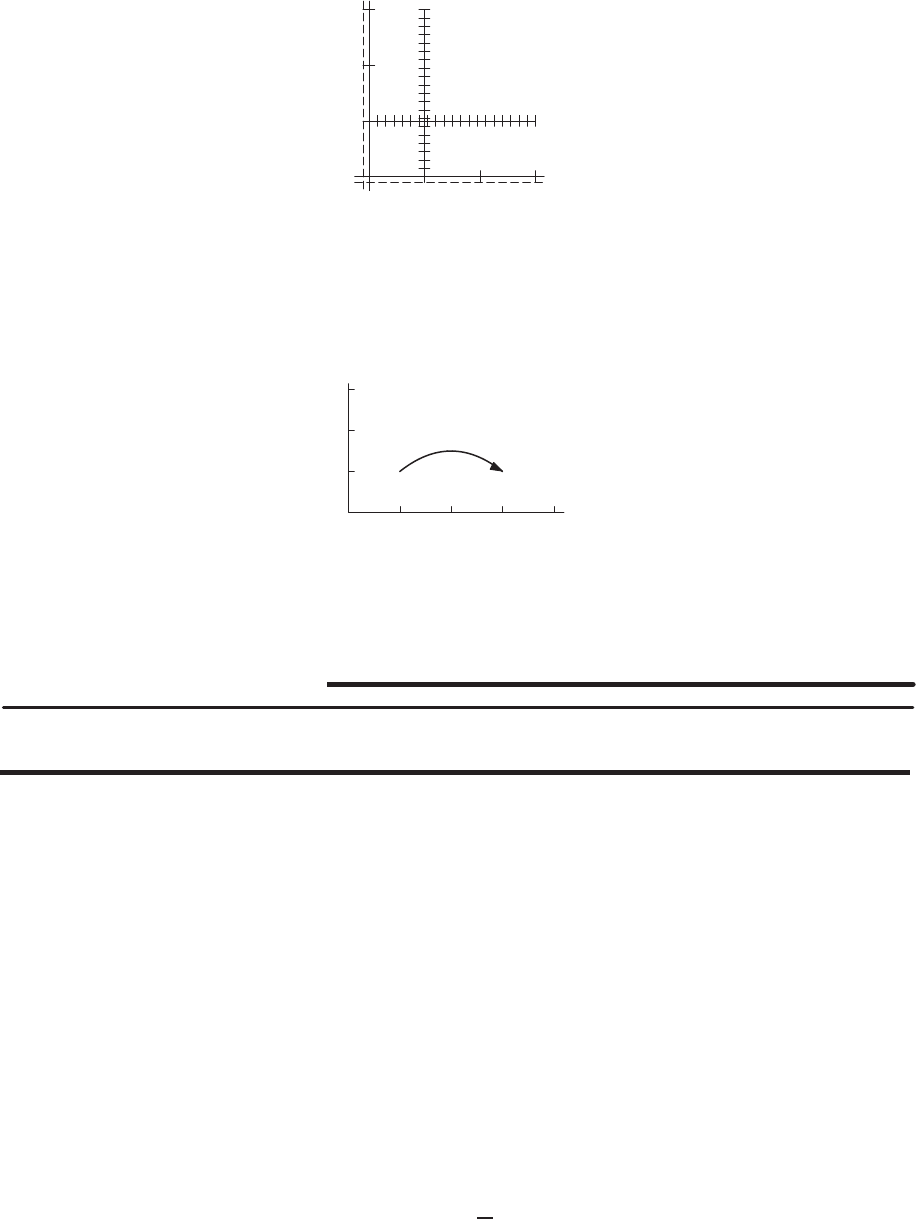
SOLUTIONS to Review Problems for Chapter Eleven 1113
1 2 3
1
2
3
x
y
Figure 11.98
28. We follow the directions, and use the fact that if the trajectory crosses the nullcline x= 2, it is horizontal there and then
bends down. See Figure 11.99. Other answers are possible.
1 2 3 4
1
2
3
x
y
Figure 11.99
Solutions for Chapter 11 Review
Exercises
1. For (I): y=xex, y′=ex+xex,and y′′ = 2ex+xex.
For (II): y=xe−x, y′=e−x−xe−x,and y′′ =−2e−x+xe−x.
Thus (I) satisfies equation (d).
(II) satisfies equation (c).
2. (a) Since y′= 1 + y2, the slope is everywhere positive. This is true for slope field (III).
(b) Since y=x, the slopes are positive to the right of the y-axis and negative to the left of the y-axis. Solution curves
are parabolas, as in slope field (VI).
(c) Since y′= sin x, the slopes oscillate between −1and 1. This corresponds to slope field (V).
(d) Since y′=y, the slopes are positive above the x-axis and negative below the x-axis. This is true for slope field (I).
(e) Since y′=x−y, the slopes are zero when x=y. This corresponds to slope field (IV).
(f) Since y′= 4 −y, the slopes are positive when y < 4and negative when y > 4. This corresponds to slope field (II).
3. (a) = (I), (b) = (IV), (c) = (III). Graph (II) represents an egg originally at 0◦C which is moved to the kitchen table (20◦
C) two minutes after the egg in part (a) is moved.
4. This equation is separable, so we integrate, giving
ZdP =Zt dt
so
P(t) = t2
2+C.

1114 Chapter Eleven /SOLUTIONS
5. This equation is separable, so we integrate, giving
Z1
0.2y−8dy =Zdx
so1
0.2ln |0.2y−8|=x+C.
Thus
y(x) = 40 + Ae0.2x.
6. This equation is separable, so we integrate, giving
Z1
10 −2PdP =Zdt
so 1
−2ln |10 −2P|=t+C.
Thus
P= 5 + Ae−2t.
7. This equation is separable, so we integrate, giving
Z1
10 + 0.5HdH =Zdt
so 1
0.5ln |10 + 0.5H|=t+C.
Thus
H=Ae0.5t−20.
8. This equation is separable, so we integrate, using the table of integrals or partial fractions, to get
Z1
R−3R2dR = 2 Zdt
Z1
RdR +Z3
1−3RdR = 2 Zdt
so
ln |R| − ln |1−3R|= 2t+C
ln
R
1−3R= 2t+C
R
1−3R=Ae2t
R=Ae2t
1 + 3Ae2t.
9. This equation is separable, so we integrate, using the table of integrals or partial fractions, to get:
Z250
100P−P2dP =Zdt
250
100 Z1
PdP +Z1
100 −PdP =Zdt
so
2.5(ln |P| − ln |100 −P|) = t+C
2.5 ln
P
100 −P=t+C
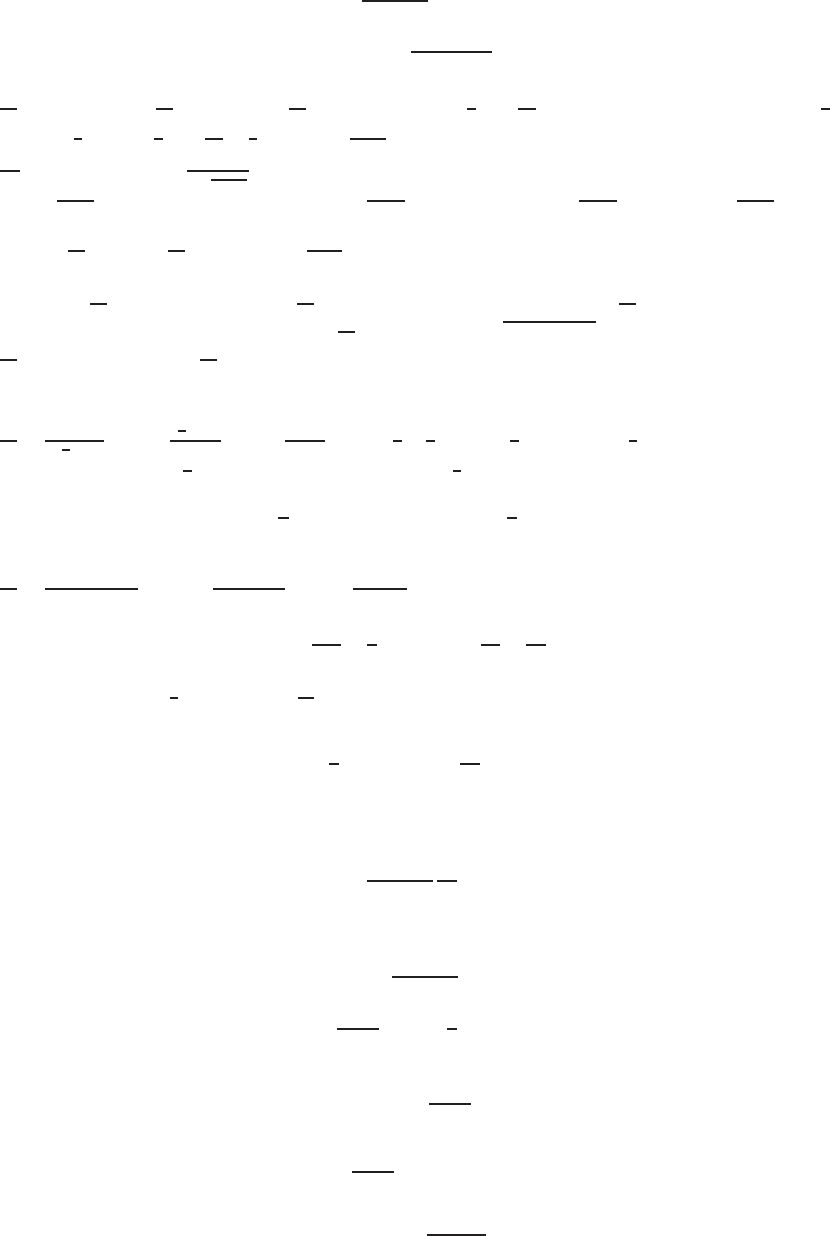
SOLUTIONS to Review Problems for Chapter Eleven 1115
P
100 −P=Ae0.4t
P=100Ae0.4t
1 + Ae0.4t
10. dy
dx +xy2= 0 means dy
dx =−xy2, so Rdy
y2=R−x dx giving −1
y=−x2
2+C. Since y(1) = 1 we have −1 = −1
2+C
so C=−1
2. Thus, −1
y=−x2
2−1
2giving y=2
x2+1 .
11. dP
dt = 0.03P+ 400 so RdP
P+40000
3
=R0.03dt.
ln |P+40000
3|= 0.03t+Cgiving P=Ae0.03t−40000
3. Since P(0) = 0, A =40000
3, therefore P=40000
3(e0.03t−1).
12. 1 + y2−dy
dx = 0 gives dy
dx =y2+ 1, so Rdy
1+y2=Rdx and arctan y=x+C. Since y(0) = 0 we have C= 0, giving
y= tan x.
13. 2 sin x−y2dy
dx = 0 giving 2 sin x=y2dy
dx .R2 sin x dx =Ry2dy so −2 cos x=y3
3+C. Since y(0) = 3 we have
−2 = 9 + C, so C=−11. Thus, −2 cos x=y3
3−11 giving y=3
√33 −6 cos x.
14. dk
dt = (1 + ln t)kgives Rdk
k=R(1 + ln t)dt so ln |k|=tln t+C.k(1) = 1,so 0 = 0 + C, or C= 0.Thus,
ln |k|=tln tand |k|=etln t=tt, giving k=±tt.
But recall k(1) = 1,so k=ttis the solution.
15. dy
dx =y(3−x)
x(1
2y−4) gives R(1
2y−4)
ydy =R(3−x)
xdx so R(1
2−4
y)dy =R(3
x−1)dx. Thus 1
2y−4 ln |y|= 3 ln |x|−x+C.
Since y(1) = 5, we have 5
2−4 ln 5 = ln |1| − 1 + Cso C=7
2−4 ln 5. Thus,
1
2y−4 ln |y|= 3 ln |x| − x+7
2−4 ln 5.
We cannot solve for yin terms of x, so we leave the equation in this form.
16. dy
dx =0.2y(18+0.1x)
x(100+0.5y)giving R(100+0.5y)
0.2ydy =R18+0.1x
xdx, so
Z500
y+5
2dy =Z18
x+1
10 dx.
Therefore, 500 ln |y|+5
2y= 18 ln |x|+1
10 x+C. Since the curve passes through (10,10), 500 ln 10 + 25 = 18 ln 10 +
1 + C, so C= 482 ln 10 + 24.Thus, the solution is
500 ln |y|+5
2y= 18 ln |x|+1
10 x+ 482 ln 10 + 24.
We cannot solve for yin terms of x, so we leave the answer in this form.
17. This equation is separable and so we write it as
1
z(z−1)
dz
dt = 1.
We integrate with respect to t, giving
Z1
z(z−1) dz =Zdt
Z1
z−1dz −Z1
zdz =Zdt
ln |z−1| − ln |z|=t+C
ln |z−1
z|=t+C,
so that z−1
z=et+C=ket.
Solving for zgives
z(t) = 1
1−ket.
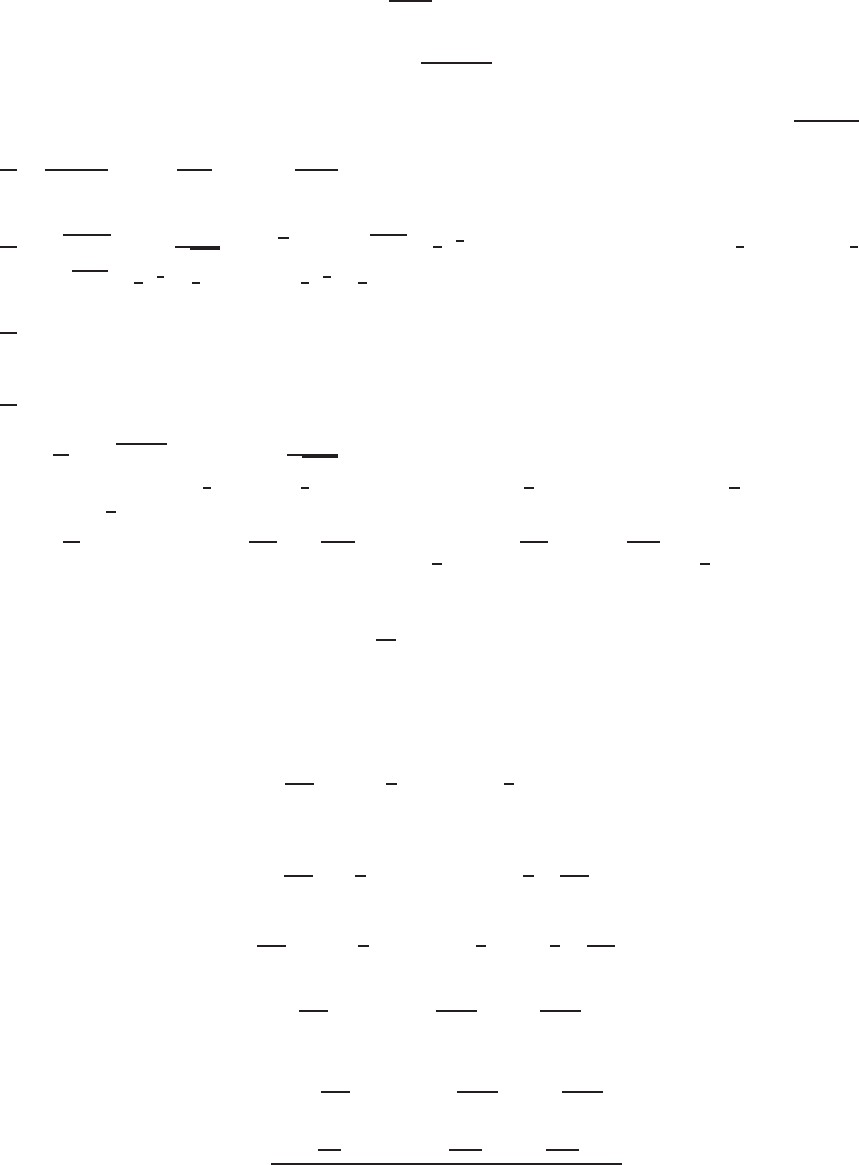
1116 Chapter Eleven /SOLUTIONS
The initial condition z(0) = 10 gives
1
1−k= 10
or k= 0.9. The solution is therefore
z(t) = 1
1−0.9et.
18. Using the solution of the logistic equation given on page 631 in Section 11.7, and using y(0) = 1,we get y=10
1+9e−10t.
19. dy
dx =y(100−x)
x(20−y)gives R(20−y
y)dy =R100−x
xdx. Thus, 20 ln |y|−y= 100 ln |x|−x+C. The curve passes through
(1,20), so 20 ln 20 −20 = −1 + Cgiving C= 20 ln 20 −19. Therefore, 20 ln |y|−y= 100 ln |x|−x+ 20 ln 20 −19.
We cannot solve for yin terms of x, so we leave the equation in this form.
20. df
dx =pxf(x)gives Rdf
√f(x)=R√x dx, so 2pf(x) = 2
3x3
2+C. Since f(1) = 1,we have 2 = 2
3+Cso C=4
3.
Thus, 2pf(x) = 2
3x3
2+4
3, so f(x) = ( 1
3x3
2+2
3)2.
(Note: this is only defined for x≥0.)
21. dy
dx =ex−ygiving Reydy =Rexdx so ey=ex+C. Since y(0) = 1, we have e1=e0+Cso C=e−1. Thus,
ey=ex+e−1, so y= ln(ex+e−1).
[Note: ex+e−1>0always.]
22. dy
dx =ex+y=exeyimplies Re−ydy =Rexdx implies −e−y=ex+C. Since y= 0 when x= 1,we have
−1 = e+C, giving C=−1−e. Therefore −e−y=ex−1−eand y=−ln(1 + e−ex).
23. e−cos θdz
dθ =√1−z2sin θimplies Rdz
√1−z2=Recos θsin θ dθ implies arcsin z=−ecos θ+C. According to the
initial conditions: z(0) = 1
2,so arcsin 1
2=−ecos 0 +C, therefore π
6=−e+C, and C=π
6+e. Thus z=
sin(−ecos θ+π
6+e).
24. (1+t2)ydy
dt = 1−yimplies that Ry dy
1−y=Rdt
1+t2implies that R−1 + 1
1−ydy =Rdt
1+t2. Therefore −y−ln |1−y|=
arctan t+C.y(1) = 0,so 0 = arctan 1 + C, and C=−π
4, so −y−ln |1−y|= arctan t−π
4.We cannot solve for
yin terms of t.
25. We have dy
dt = 2ysin3t,
so Z2−ydy =Zsin3t dt.
Using Integral Table Formula 17, gives
−1
ln 2 2−y=−1
3sin2tcos t−2
3cos t+C.
According to the initial conditions: y(0) = 0 so
−1
ln 2 =−2
3+C, and C=2
3−1
ln 2 .
Thus,
−1
ln 2 2−y=−1
3sin2tcos t−2
3cos t+2
3−1
ln 2 .
Solving for ygives:
2−y=ln 2
3sin2tcos t+2 ln 2
3cos t−2 ln 2
3+ 1.
It can be shown that the right side is always >0, so we can take natural logs.
yln 2 = −ln ln 2
3sin2tcos t+2 ln 2
3cos t−2 ln 2
3+ 1,
so
y=−ln ln 2
3sin2tcos t+2 ln 2
3cos t−2 ln 2
3+ 1
ln 2 .
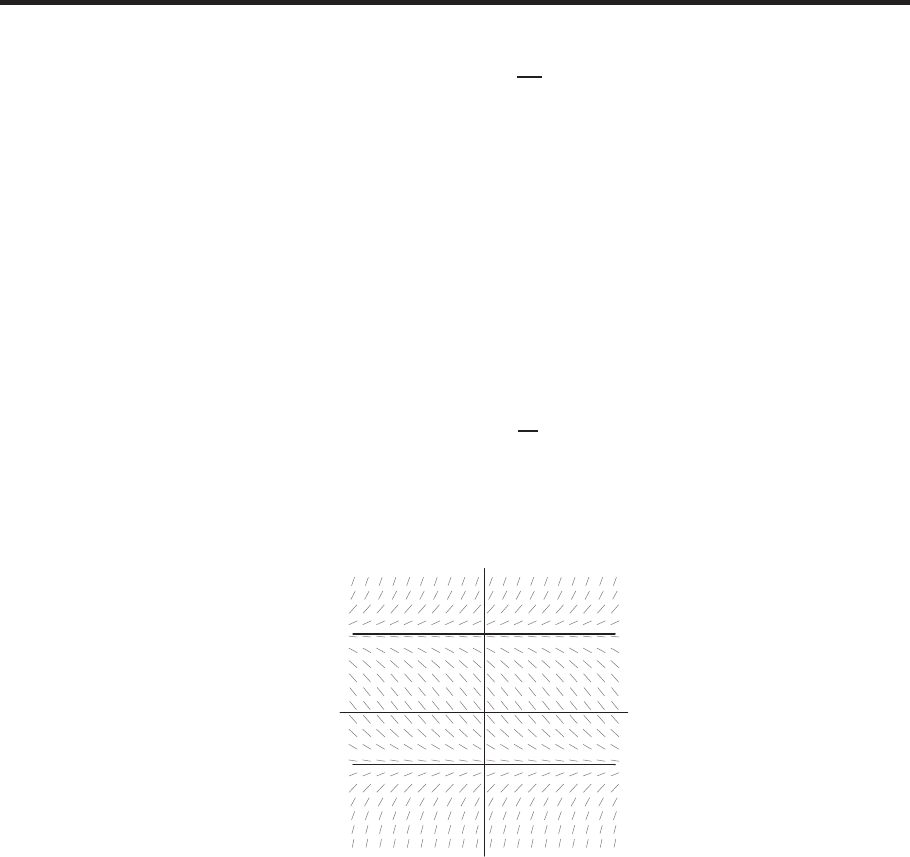
SOLUTIONS to Review Problems for Chapter Eleven 1117
Problems
26. (a) To find equilibrium values, we solve
dP
dt = 0
0.025P−0.00005P2= 0
0.025P(1 −0.002P) = 0
P= 0 and P= 500.
The equilibrium values are P= 0 and P= 500.
(b) Between 0 and 500, Pis increasing. Above 500, Pis decreasing. We have:
(i) For P0= 100, the population will increase to a limiting value of 500.
(ii) For P0= 400, the population will increase to a limiting value of 500.
(iii) For P0= 500, the population is at equilibrium and will stay at 500.
(iv) For P0= 800, the population will decrease to a limiting value of 500.
27. (a) We know that the equilibrium solutions are the functions satisfying the differential equation whose derivative every-
where is 0. Thus we have
dy
dt = 0
0.2(y−3)(y+ 2) = 0
(y−3)(y+ 2) = 0.
The solutions are y= 3 and y=−2.
(b) y
t
Figure 11.100
Looking at Figure 11.100, we see that the line y= 3 is an unstable solution, while the line y=−2is a stable
solution.
28. Since f(x)is a solution to y′=xy −y, we know that
f′(x) = xf(x)−f(x).
Letting y= 2f(x), we want to find out if the left-hand side of this differential equation, y′, equals the right-hand side,
xy −y. First we consider the left-hand side:
y′= (2f(x))′
= 2f′(x)
= 2 (xf(x)−f(x)) since f′(x) = xf(x)−f(x)
= 2xf(x)−2f(x).
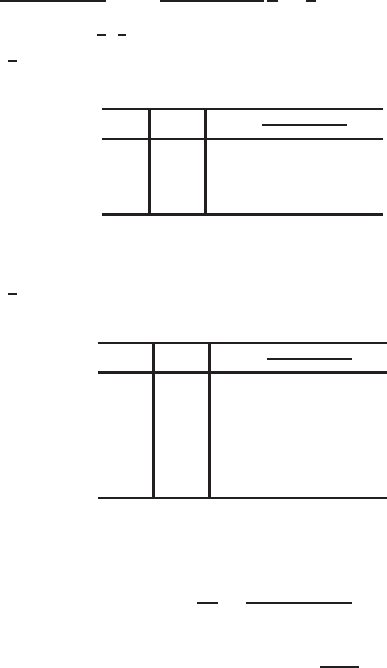
1118 Chapter Eleven /SOLUTIONS
Turning to the right-hand side, we see that:
xy −y=x(2f(x)) −2f(x)because y= 2f(x)
= 2xf(x)−2f(x),
We see that the left-hand side and the right-hand side both equal 2xf (x)−2f(x), so y= 2f(x)is also a solution to the
equation.
29. Since y=f(x)is a solution to y′=xy −y, we know that
f′(x) = xf(x)−f(x).
Letting y= 2 + f(x), we want to find out if the left-hand side of this differential equation, y′, equals the right-hand side,
xy −y. First we consider the left-hand side:
y′= (f(x) + 2)′
=f′(x)
=xf(x)−f(x)since f′(x) = xf(x)−f(x).
Turning to the right-hand side, we see that:
xy −y=x(2 + f(x)) −(2 + f(x)) because y= 2 + f(x)
=xf(x)−f(x) + 2x−2.
We see that the left-hand side, xf(x)−f(x), is not the same as the right-hand side, xf(x)−f(x)+2x−2, so y= 2+f(x)
is not a solution to the equation.
30. (a) (i) 1 step: ∆y=1
(cos x)(cos y)∆x=1
(cos 0)(cos 0)
1
2=1
2.
Thus, using 1 step, we get (1
2,1
2)as our approximation.
(ii) 2 steps: ∆x=1
4.
x y ∆y=1
(cos x)(cos y)∆x
0 0 0.25
0.25 0.25 0.266
0.5 0.516
Thus, using 2 steps, we get (0.5,0.516) as our approximation.
(iii) 4 steps: ∆x=1
8
x y ∆y=1
(cos x)(cos y)∆x
0 0 0.125
0.125 0.125 0.127
0.25 0.252 0.133
0.375 0.385 0.145
0.5 0.530
Thus, using 4 steps, we get (0.5,0.530) as our approximation.
(b) We have
dy
dx =1
(cos x)(cos y),
so Zcos y dy =Zdx
cos x.
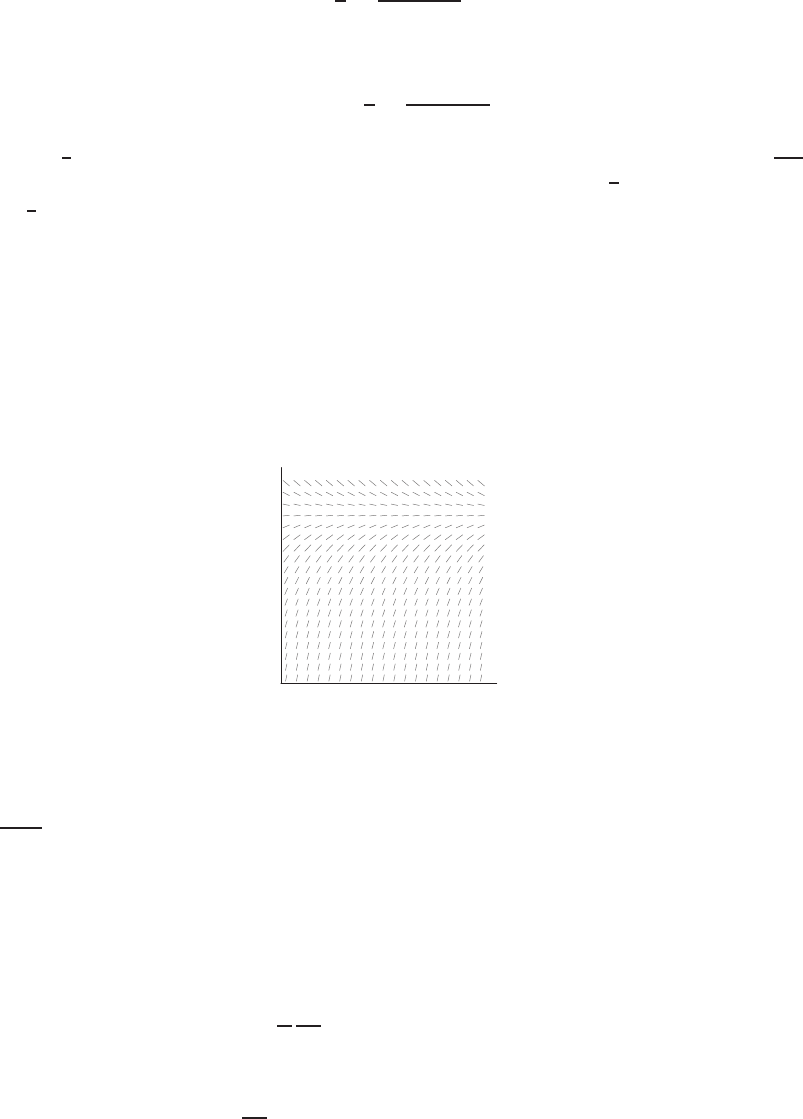
SOLUTIONS to Review Problems for Chapter Eleven 1119
The integral table gives
sin y=1
2ln
(sin x) + 1
(sin x)−1+C.
Our curve passes through (0,0), so, 0 = 0 + C, and C= 0. Therefore
y= arcsin 1
2ln
(sin x) + 1
(sin x)−1.
When x=1
2,y≈0.549. Our answers in parts (a)-(c) are all underestimates. In each case, the error is about 1
n+1 ,
where nis the number of steps. We expect the error to be approximately proportional to 1
n, so this seems reasonable.
31. (a) ∆x=1
5= 0.2.
At x= 0:
y0= 1,y′= 4; so ∆y= 4(0.2) = 0.8. Thus, y1= 1 + 0.8 = 1.8.
At x= 0.2:
y1= 1.8, y′= 3.2; so ∆y= 3.2(0.2) = 0.64. Thus, y2= 1.8 + 0.64 = 2.44.
At x= 0.4:
y2= 2.44, y′= 2.56; so ∆y= 2.56(0.2) = 0.512. Thus, y3= 2.44 + 0.512 = 2.952.
At x= 0.6:
y3= 2.952, y′= 2.048; so ∆y= 2.048(0.2) = 0.4096. Thus, y4= 3.3616.
At x= 0.8:
y4= 3.3616, y′= 1.6384; so ∆y= 1.6384(0.2) = 0.32768. Thus, y5= 3.68928.So y(1) ≈3.689.
(b)
5
5
x
y
Since solution curves are concave down for 0≤y≤5, and y(0) = 1 <5, the estimate from Euler’s method
will be an overestimate.
(c) Solving by separation:
Zdy
5−y=Zdx,so −ln |5−y|=x+C.
Then 5−y=Ae−xwhere A=±e−C. Since y(0) = 1,we have 5−1 = Ae0, so A= 4.
Therefore, y= 5 −4e−x,and y(1) = 5 −4e−1≈3.528.
(Note: as predicted, the estimate in (a) is too large.)
(d) Doubling the value of nwill probably halve the error and, therefore, give a value half way between 3.528 and 3.689,
which is approximately 3.61.
32. A continuous growth rate of 0.38% means that
1
P
dP
dt = 0.38% = 0.0038.
Separating variables and integrating gives
ZdP
P=Z0.0038 dt
P=P0e0.0038t= (7.5·106)e0.0038t.

1120 Chapter Eleven /SOLUTIONS
33. (a) Assuming that the world’s population grows exponentially, satisfying dP/dt =cP, and that the land in use for crops
is proportional to the population, we expect Ato satisfy dA/dt =kA.
(b) We have A(t) = A0ekt = 4.55 ·109ekt,where tis the number of years after 1966. Since 30 years later the amount
of land in use is 4.93 billion hectares, we have
4.93 ·109= (4.55 ·109)ek(30),
so
e30k=4.93
4.55 .
Solving for kgives
k=ln (4.93/4.55)
30 = 0.00267.
Thus,
A= (4.55 ·109)e0.00267t.
We want to find tsuch that
6·109=A(t) = (4.55 ·109)e0.00267t.
Taking logarithms gives
t=ln (6/4.55)
0.00267 = 103.608 years.
This model predicts land will have run out 104 years after 1966, that is by the year 2070.
34. (a) Since the growth rate of the tumor is proportional to its size, we should have
dS
dt =kS.
(b) We can solve this differential equation by separating variables and then integrating:
ZdS
S=Zk dt
ln |S|=kt +B
S=Cekt.
(c) This information is enough to allow us to solve for C:
5 = Ce0t
C= 5.
(d) Knowing that C= 5, this second piece of information allows us to solve for k:
8 = 5e3k
k=1
3ln 8
5≈0.1567.
So the tumor’s size is given by
S= 5e0.1567t.
35. (a) The rate of growth of the money in the account is proportional to the amount of money in the account. Thus
dM
dt =rM.
(b) Solving, we have dM/M =r dt.
ZdM
M=Zr dt
ln|M|=rt +C
M=ert+C=Aert, A =eC.
When t= 0 (in 2010), M= 2000,so A= 2000 and M= 2000ert.

SOLUTIONS to Review Problems for Chapter Eleven 1121
(c) See Figure 11.101.
t= 0
2010 t= 30
2040
2000
10000
40000
t
M
M= 2000e0.05t
M= 2000e0.10t
Figure 11.101
36. We know that Rate at which quantity of
carbon-14 is changing =−k(current quantity).
If Qis the quantity of carbon-14 at time t(in years),
Rate at which quantity is changing =dQ
dt =−kQ.
This differential equation has solution
Q=Q0e−kt
where Q0is the initial quantity. Since at the end of one year 9999 parts are left out of 10,000, we know that
9999 = 10,000e−k(1).
Solving for kgives
k= ln 0.9999 ≈0.0001.
Thus Q=Q0e−0.0001t. See Figure 11.102.
Q0
Q=Q0e−0.0001t
t
Q
Figure 11.102
: Exponential decay
37. Using (Rate balance changes) = (Rate interest is added)−(Rate payments are made), when the interest rate is i, we have
dB
dt =iB −100.
Solving this equation, we find:
dB
dt =iB−100
i
ZdB
B−100
i
=Zi dt
lnB−100
i=it +C
B−100
i=Aeit,where A=±eC.
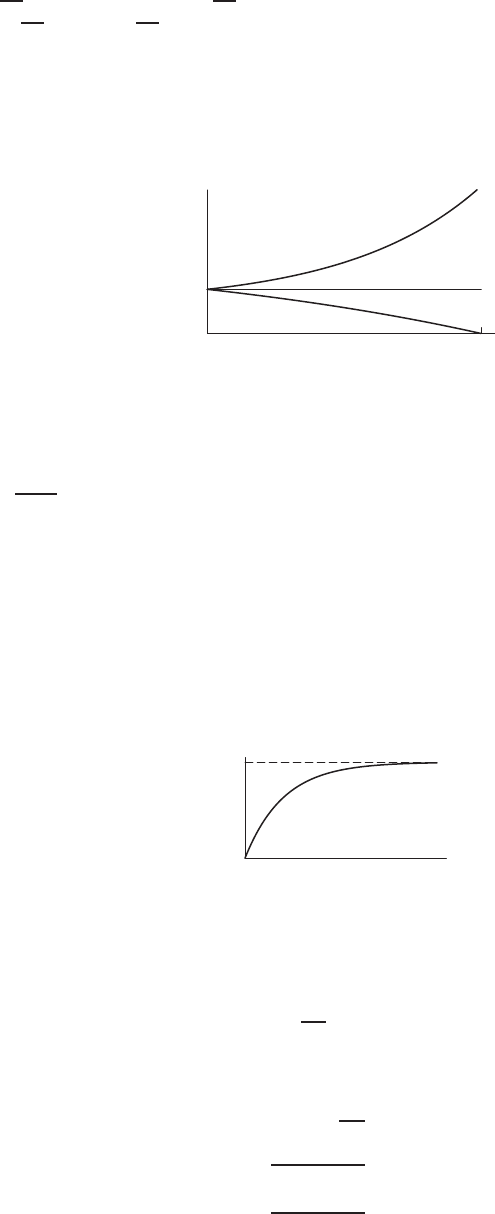
1122 Chapter Eleven /SOLUTIONS
At time t= 0 we start with a balance of $1000. Thus
1000 −100
i=Ae0,so A= 1000 −100
i.
Thus B=100
i+ (1000 −100
i)eit.
When i= 0.05, B = 2000 −1000e0.05t.
When i= 0.1, B = 1000.
When i= 0.15, B = 666.67 + 333.33e0.15t.
We now look at the graph in Figure 11.103 when i= 0.05, i = 0.1,and i= 0.15.
t≈13.86
1000 i= 0.1
i= 0.15
i= 0.05
years
B
Figure 11.103
38. (a) c′(t) = a(k−c(t)) where a > 0is a constant.
(b) Zdc
k−c=Za dt
−ln |k−c|=at +C, C is a constant of integration
k−c=Ae−at
If c=c0when t= 0, then k−c0=A, so
k−c= (k−c0)e−at
c=k+ (c0−k)e−at
(c) If c0= 0, then c=k−ke−at =k(1 −e−at).
k
concentration
t
(time)
c(t) = k(1 −e−at)
39. (a) Use the fact that
Rate balance
changing =Rate interest
accrued −Rate payments
made .
Thus dB
dt = 0.05B−12,000.
(b) We solve the equation by separation of variables. First, however, we factor out a 0.05 on the right hand side of the
equation to make the work easier.
dB
dt = 0.05(B−240000)
dB
B−240000 = 0.05 dt
ZdB
B−240000 =Z0.05 dt,

SOLUTIONS to Review Problems for Chapter Eleven 1123
so
ln |B−240000|= 0.05t+C
|B−240000|=e0.05t+C=e0.05teC,
so B−240000 = Ae0.05t,where A=±eC.
If the initial balance is B0, then B0−240000 = Ae0=A, thus B−240000 = (B0−240000)e0.05t, so
B= (B0−240000)e0.05t+ 240000.
(c) To find the initial balance such that the account has a 0 balance after 20 years, we solve
0 = (B0−240,000)e(0.05)20 + 240,000 = (B0−240,000)e1+ 240,000,
B0= 240,000 −240,000
e≈$151,708.93.
40. (a) Since the rate of change is proportional to the amount present, dy/dt =ky for some constant k.
(b) Solving the differential equation, we have y=Aekt,where Ais the initial amount. Since 100 grams become 54.9
grams in one hour, 54.9 = 100ek,so k= ln(54.9/100) ≈ −0.5997.
Thus, after 10 hours, there remains 100e(−0.5997)10 ≈0.2486 grams.
41. Let C(t)be the current flowing in the circuit at time t, then
dC
dt =−αC
where α > 0is the constant of proportionality between the rate at which the current decays and the current itself.
The general solution of this differential equation is C(t) = Ae−αt but since C(0) = 30, we have that A= 30, and
so we get the particular solution C(t) = 30e−αt.
When t= 0.01, the current has decayed to 11 amps so that 11 = 30e−α0.01 which gives α=−100 ln(11/30) =
100.33 so that,
C(t) = 30e−100.33t.
42. Since the rate at which the volume, V, is decreasing is proportional to the surface area, A, we have
dV
dt =−kA,
where the negative sign reflects the fact that Vis decreasing. Suppose the radius of the sphere is r. Then V=4
3πr3and,
using the chain rule, dV
dt = 4πr2dr
dt . The surface area of a sphere is given by A= 4πr2. Thus
4πr2dr
dt =−k4πr2
so dr
dt =−k.
Since the radius decreases from 1cm to 0.5cm in 1month, we have k= 0.5cm/month. Thus
dr
dt =−0.5
so
r=−0.5t+r0.
Since r= 1 when t= 0, we have r0= 1, so
r=−0.5t+ 1.
We want to find twhen r= 0.2, so
0.2 = −0.5t+ 1
and
t=0.8
0.5= 1.6months.
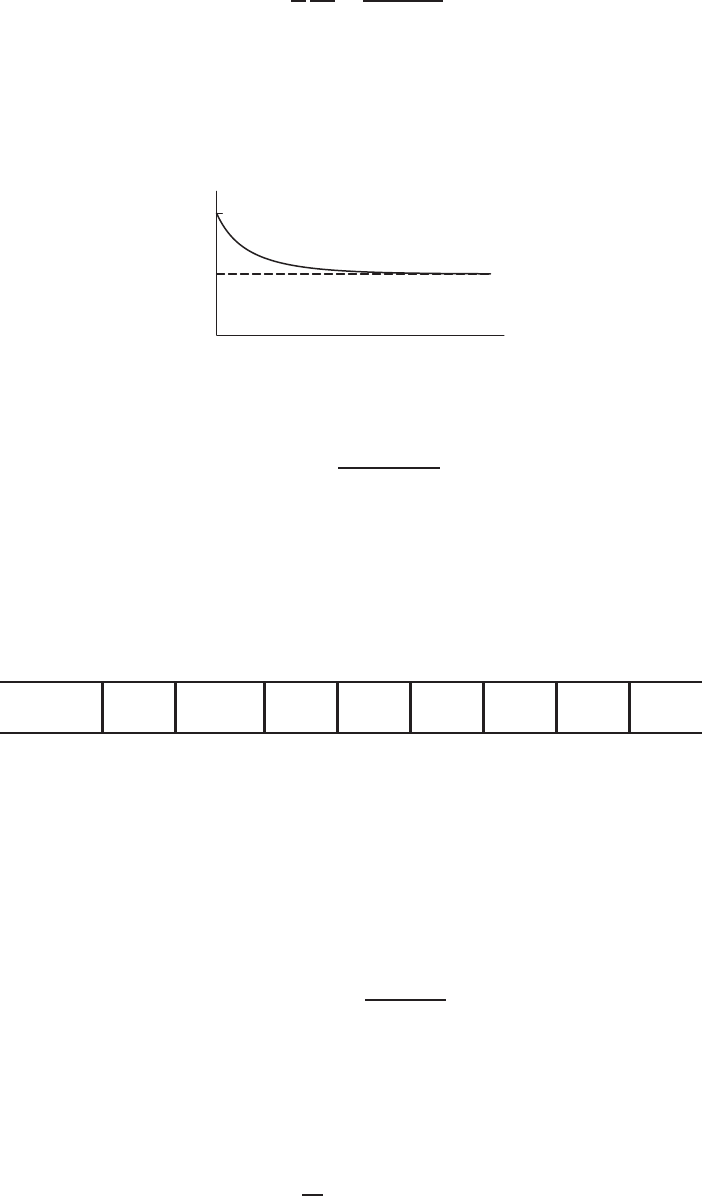
1124 Chapter Eleven /SOLUTIONS
43. By rewriting the equation, we see that it is logistic:
1
P
dP
dt =(100 −P)
1000 .
Before looking at its solution, we explain why there must always be at least 100 individuals. Since the population begins
at 200, the quantity dP/dt is initially negative, so the population initially decreases. It continues to do so while P > 100.
If the population ever reached 100, then dP/dt would be 0. This would mean the population stopped changing—so if the
population ever decreased to 100, that’s where it would stay. The fact that dP/dt is always negative for P > 100 also
shows that the population is always under 200, as shown in Figure 11.104.
100
200
t
P
Figure 11.104
The solution, as given by the formula derived in the chapter, is
P=100
1−0.5e−0.1t
44. (a) The logistic model is a reasonable one because in the 1990s, very few households had DVD players. Since DVD
disc media is more convenient than VHS tape media, as DVD players dropped in price, more people bought them.
However, the rate of DVD-player ownership had to start slowing down at some point as it is impossible for more than
100% of households to have DVD players.
(b) To find the point of inflection, we find the year at which the increase in DVD-player ownership alters from increasing
to decreasing. The following table from 1998 to 2006.
Year 1998-99 1999-2000 2000-01 2001-02 2002-03 2003-04 2004-05 2005-06
Change in % 4 8 8 14 15 20 5 6
Looking at the table, we see that the change in percent alters from increasing to decreasing in about 2003. At this
time 50% of households own DVD players. The inflection point is approximately (2003,50). Since at the inflection
point on a logistic curve, the vertical coordinate is L/2, we have
L/2 = 50
L= 100.
Thus the limiting value is about 100%. Ownership may be expected to rise until the next new media format replaces
it.
(c) Since the general form of a logistic function is
P=L
1 + Ae−kt
where Lis the limiting value, in this case we have L= 86.395, predicting a limiting value of 86.395%.
45. (a) Quantity of Apresent at time tequals (a−x).
Quantity of Bpresent at time tequals (b−x).
So
Rate of formation of C=k(Quantity of A)(Quantity of B)
gives
dx
dt =k(a−x)(b−x)
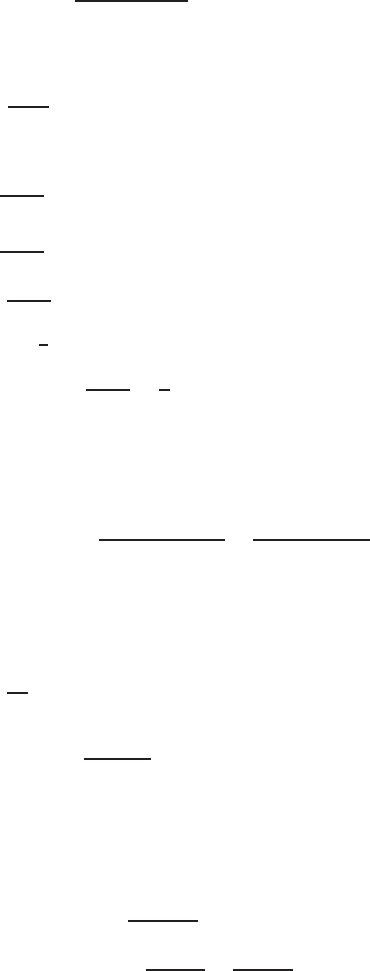
SOLUTIONS to Review Problems for Chapter Eleven 1125
(b) Separating gives Zdx
(a−x)(b−x)=Zk dt.
Rewriting the denominator as (a−x)(b−x) = (x−a)(x−b)enables us to use Formula 26 in the Table of Integrals
provided a6=b. For some constant K, this gives
1
a−b(ln |x−a| − ln |x−b|) = kt +K.
Thus
ln
x−a
x−b= (a−b)kt +K(a−b)
x−a
x−b=eK(a−b)e(a−b)kt
x−a
x−b=Me(a−b)kt where M=±eK(a−b).
Since x= 0 when t= 0, we have M=a
b. Thus
x−a
x−b=a
be(a−b)kt.
Solving for x, we have
bx −ba =ae(a−b)kt(x−b)
x(b−ae(a−b)kt) = ab −abe(a−b)kt
x=ab(1 −e(a−b)kt)
b−ae(a−b)kt =ab(ebkt −eakt)
bebkt −aeakt .
46. Quantity of Aleft at time t=Quantity of Bleft at time tequals (a−x).
Thus
Rate of formation of C=k(Quantity of A)(Quantity of B)
gives
dx
dt =k(a−x)(a−x) = k(a−x)2.
Separating gives Zdx
(x−a)2=Zk dt
Integrating gives, for some constant K,
−(x−a)−1=kt +K.
When t= 0,x= 0 so K=a−1. Solving for x:
−(x−a)−1=kt +a−1
x−a=−1
kt +a−1
x=a−a
akt + 1 =a2kt
akt + 1
47. (a) If alone, the xpopulation grows exponentially, since if y= 0 we have dx/dt = 0.01x. If alone, the ypopulation
decreases to 0 exponentially, since if x= 0 we have dy/dt =−0.2y.
(b) This is a predator-prey relationship: interaction between populations xand ydecreases the xpopulation and increases
the ypopulation. The interaction of lions and gazelles might be modeled by these equations.
48. (a) If alone, the xand ypopulations each grow exponentially, because the equations become dx/dt = 0.01xand
dy/dt = 0.2y.
(b) For each population, the presence of the other decreases their growth rate. The two populations are therefore competitors—
they may be eating each other’s food, for instance. The interaction of gazelles and zebras might be modeled by these
equations.
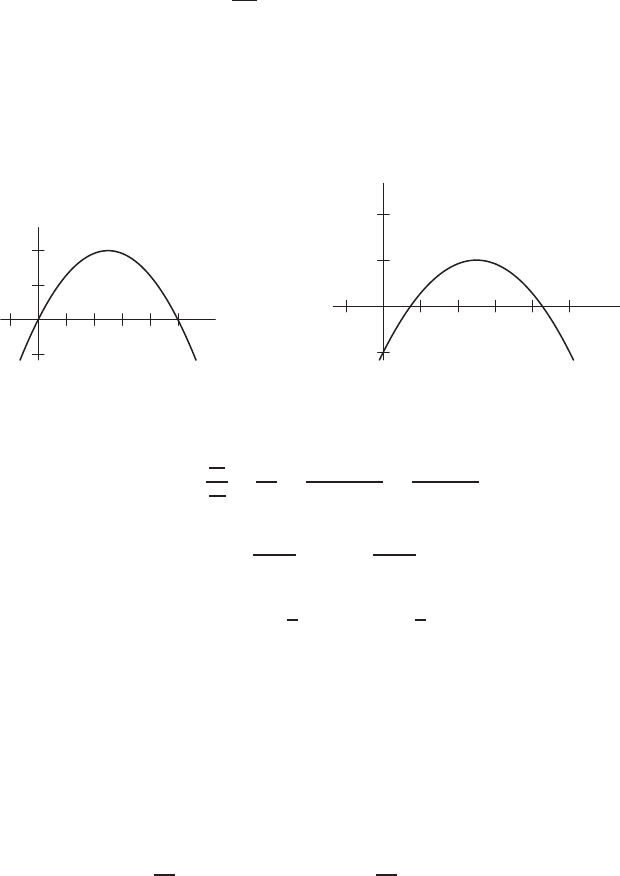
1126 Chapter Eleven /SOLUTIONS
49. (a) The xpopulation is unaffected by the ypopulation—it grows exponentially no matter what the ypopulation is, even
if y= 0. If alone, the ypopulation decreases to zero exponentially, because its equation becomes dy/dt =−0.1y.
(b) Here, interaction between the two populations helps the ypopulation but does not effect the xpopulation. This is not
a predator-prey relationship; instead, this is a one-way relationship, where the ypopulation is helped by the existence
of x’s. These equations could, for instance, model the interaction of rhinoceroses (x)and dung beetles (y).
50. (a) See Figure 11.105.
(b) The two equilibrium values are P= 0 and P= 100. Given any positive initial condition, the shrimp population will
level off at 100 tons of shrimp in the bay.
(c) The new differential equation is
dP
dt = 0.8P(1 −0.01P)−10.
(d) Notice that subtracting 10 just moves the graph of dP/dt against Pdown 10 units. See Figure 11.106.
(e) We see in Figure 11.106 that the equilibrium values are at approximately P= 14.6and P= 85.4.
(f) We see in Figure 11.106 that if P= 12, then dP/dt is negative. The shrimp population will decrease from P= 12.
If P= 25 or P= 75, we see in Figure 11.106 that dP/dt is positive, so the shrimp populations will increase from
either of these populations.
−20 20 40 60 80 100
−10
10
20
P
dP/dt
Figure 11.105
−20 20 40 60 80 100
−10
10
20
P
dP/dt
Figure 11.106
51. (a) We have
dy
dt
dx
dt
=dy
dx =−3y−xy
−2x−xy =y(x+ 3)
x(y+ 2) .
Thus, y+2
ydy =x+ 3
xdx
so Z(1 + 2
y)dy =Z(1 + 3
x)dx.
So,
y+ 2 ln |y|=x+ 3 ln |x|+C.
Since xand yare non-negative,
y+ 2 ln y=x+ 3 ln x+C.
This is as far as we can go with this equation – we cannot solve for yin terms of x, for example. We can, however,
put it in the form
ey+2 ln y=ex+3 ln x+C,or y2ey=Ax3ex.
(b) An equilibrium state satisfies
dx
dt =−2x−xy = 0 and dy
dt =−3y−xy = 0.
Solving the first equation, we have
−x(y+ 2) = 0,so x= 0 or y=−2.
The second equation has solutions
y= 0 or x=−3.
Since x, y ≥0, the only equilibrium point is (0,0).

SOLUTIONS to Review Problems for Chapter Eleven 1127
(c) We can use either of our forms for the solution. Looking at
y2ey=Ax3ex,
we see that if xand yare very small positive numbers, then
ex≈ey≈1.
Thus,
y2≈Ax3,or y2
x3≈A, a constant.
Looking at
y+ 2 ln y=x+ 3 ln x+C,
we note that if xand yare small, then they are negligible compared to ln yand ln x. Thus,
2 ln y≈3 ln x+C,
giving
ln y2−ln x3≈C,
so
ln y2
x3≈C
and therefore
y2
x3≈eC,a constant.
(d) If
x(0) = 4 and y(0) = 8,
then
8 + 2 ln 8 = 4 + 3 ln 4 + C.
Note that
2 ln 8 = 3 ln 4 = ln 64,
giving
4 = C.
So the phase trajectory is
y+ 2 ln y=x+ 3 ln x+ 4.
(Or equivalently, y2ey=e4x3ex=x3ex+4.)
(e) If the concentrations are equal, then
y+ 2 ln y=y+ 3 ln y+ 4,
giving
−ln y= 4 or y=e−4.
Thus, they are equal when y=x=e−4≈0.0183.
(f) Using part (c), we have that if xis small,
y2
x3≈e4.
Since x=e−10 is certainly small,
y2
e−30 ≈e4,and y≈e−13.
52. (a) Using the chain-rule we get
dy
dx =dy/dt
dx/dt
giving
dy
dx =−ax
−ay =x
y.
so Zy dy =Zx dx,
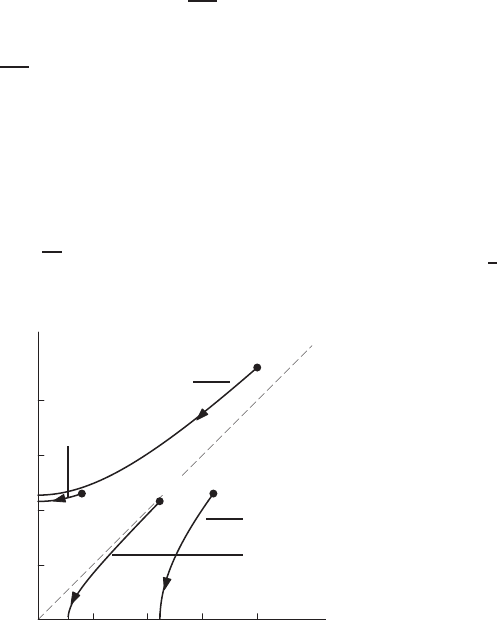
1128 Chapter Eleven /SOLUTIONS
giving
y2−x2=C.
Figure 11.107 shows the graph of the slope field of this equation with the solution satisfying y= 46 when x= 40
sketched in.
When t= 0,y= 46,x= 40, so C= 462−402= 516. Therefore, the solution is y2−x2= 516.
(b) The battle is over when x= 0. The number of French/Spanish ships remaining is the y-intercept, thus, y2−02= 516
giving y≈22.7French/Spanish ships remaining.
(c) For both sub-battles, the solution trajectory will have the form y2−x2=C. Each sub-battle will have a different
value of C.
For the 32 versus 23 sub-battle, C= 232−322=−495, so the trajectory is:
y2−x2=−495
or
x2−y2= 495.
This has no y-intercept, but an x-intercept of x=√495 ≈22.2, meaning that the model predicts the British won
the sub-battle with about 22.2 ships remaining.
For the 8 versus 23 sub-battle, C= 232−82= 465 so the trajectory is y2−x2= 465. This has no x-intercept,
but a y-intercept of y=√465 ≈21.6, meaning that the model predicts a French/Spanish victory with about 21.6
ships remaining.
(d) If the remaining ships from these two sub-battles then fight each other, the British have a slight advantage (22.2 versus
21.6). Thus the British could be expected to win the overall battle, although they started with a weaker fleet. This is
in fact what happened.
The trajectory for this last battle has C= 495 −460 = 30, so the equation is
x2−y2= 30.
This has an x-intercept of x=√30 ≈5.5, so the model predicts a British victory with about 51
2ships remaining.
5.5 10 20 22.2 30 40
10
21.6
22.7
30
40
(British)
(French/Spanish)
(40,46)
(32,23)
(8,23)
(22.2,21.6)
✲
Direct confrontation
✛
1
st
sub-battle
✛
Final battle
2
nd
sub-battle
❄
Figure 11.107
53. (a) The insects grow exponentially with no birds around (the equation becomes dx/dt = 3x); the birds die out expo-
nentially with no insects to feed on dy/dt =−10y). The interaction increases the birds’ growth rate (the +0.001xy
term is positive), but decreases the insects’ growth rate (the −0.02xy term is negative). This is as we would expect:
having the insects around helps the birds; having birds around hurts the insects.
(b) Equilibrium solutions occur where both derivatives are zero:
(3 −0.02y)x= 0
−(10 −0.001x)y= 0.
We see that the solutions are (0,0) and (10,000,150)
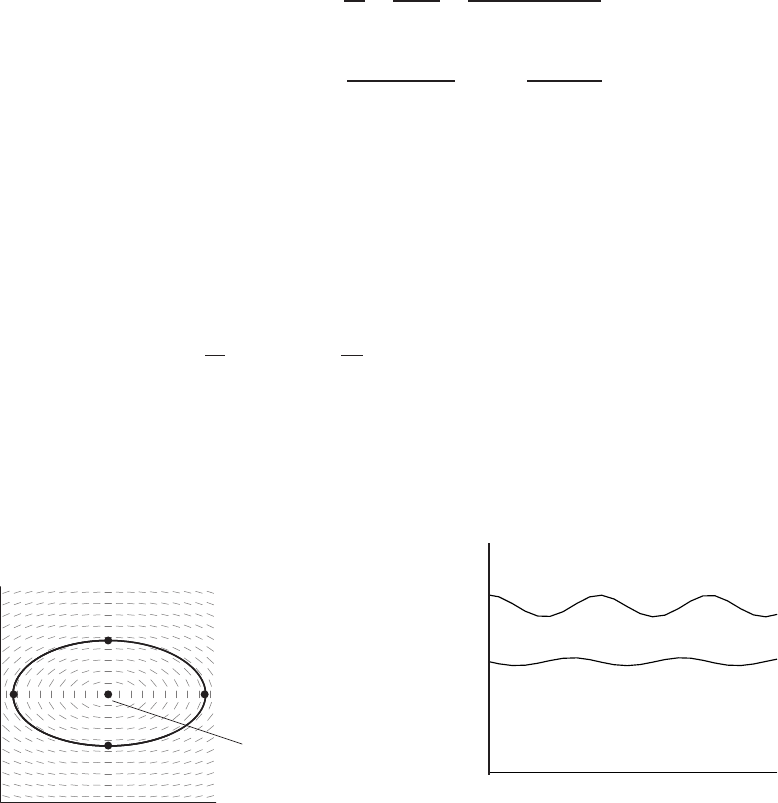
SOLUTIONS to Review Problems for Chapter Eleven 1129
(c) The chain rule gives an equation for dy/dx:
dy
dx =dy/dt
dx/dt =y(−10 + 0.001x)
x(3 −0.02y).
Separation of variables gives Z−10 + 0.001x
xdx =Z3−0.02y
ydy,
which yields 3 ln y−0.02y=−10 ln x+ 0.001x+C.
Using the initial point A= (10,000,160), we have
3 ln 160 −0.02(160) = −10 ln 10,000 + 0.001(10,000) + C.
Thus, C≈94.13 and the solution is 3 ln y−0.02y=−10 ln x+ 0.001x+ 94.1
(d) We can check that the equation is satisfied by points B,C,Dby substituting the coordinates into the equation
3 ln y−0.02y=−10 ln x+ 0.001x+ 94.1.
(e) The phase plane and the trajectory is in Figure 11.108.
(f) Consider point A. We have
dy
dt = 0,and dx
dt = 3(10,000) −0.02(10,000)(160) = −2000 <0.
Thus xis decreasing at point A. Hence the rotation is counterclockwise in the phase plane, and the order of traversal
is A−→ B−→ C−→ D.
(g) The graphs of xand yversus tare in Figure 11.109.
B D
C
A
x
y
✐
equilibrium point
(10000,150)
Figure 11.108
100
160
x
(in hundreds)
y
t
Figure 11.109
(h) At points Aand C, we have dy/dx = 0, and at Band D, we have dx/dy = 0, so these points are extrema: yis
maximized at A, minimized at C;xis maximized at D, minimized at B.
54. (a) In the equation for dx/dt, the term involving x, namely −0.2x, is negative meaning that as xincreases, dx/dt
decreases. This corresponds to the statement that the more a country spends on armaments, the less it wants to
increase spending.
On the other hand, since +0.15yis positive, as yincreases, dx/dt increases, corresponding to the fact that the
more a country’s opponent arms, the more the country will arm itself.
The constant term, 20, is positive means that if both countries are unarmed initially, (so x=y= 0), then dx/dt
is positive and so the country will start to arm. In other words, disarmament is not an equilibrium situation in this
model.
(b) The nullclines are shown in Figure 11.110. When dx/dt = 0, the trajectories are vertical (on the line −0.2x+
0.15y+ 20 = 0); when dy/dt = 0 the trajectories are horizontal (on 0.1x−0.2y+ 40 = 0). There is only one
equilibrium point, x=y= 400.
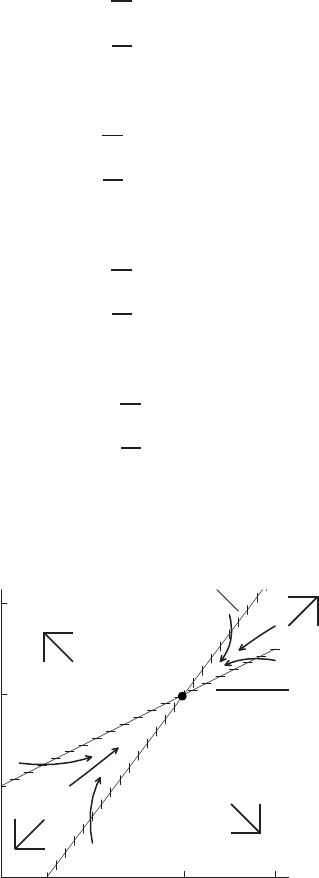
1130 Chapter Eleven /SOLUTIONS
(c) In region I, try x= 400,y= 0, giving
dx
dt =−0.2(400) + 0.15(0) + 20 <0
dy
dt = 0.1(400) −0.2(0) + 4 −0>0
In region II, try x= 500,y= 500, giving
dx
dt =−0.2(500) + 0.15(500) + 20 <0
dy
dt = 0.1(500) −0.2(500) + 40 <0
In region III, try x= 0,y= 400, giving
dx
dt =−0.2(0) + 0.15(400) + 20 >0
dy
dt = 0.1(0) −0.2(400) + 40 <0
In region IV, try x= 0,y= 0, giving
dx
dt =−0.2(0) + 0.15(0) + 20 >0
dy
dt = 0.1(0) −0.2(0) + 40 >0
See Figure 11.110.
(d) The one equilibrium point is stable.
100 400 600
200
400
600
x
(billion
$
)
y
(billion
$
)
Region III
❘
✲
❄
Region IV
✒
✲
✻
Region II
✠
✛
❄
Region I
■
✛✻
n0.1x−0.2y+ 40 = 0
dy/dt = 0
✛
−0.2x+ 0.15y+ 20 = 0
dx/dt = 0o❘
Figure 11.110
: Nullclines and equilibrium point(dot) for arms race
(e) If both sides disarm, then both sides spend $0. Thus initially x=y= 0, and dx/dt = 20 and dy/dt = 40. Since
both dx/dt and dy/dt are positive, both sides start arming. Figure 11.110 shows that they will both arm until each is
spending about $400 billion.
(f) If the country spending $ybillion is unarmed, then y= 0 and the corresponding point on the phase plane is on the
x-axis. Any trajectory starting on the x-axis tends toward the equilibrium point x=y= 400. Similarly, a trajectory
starting on the y-axis represents the other country being unarmed; such a trajectory also tends to the same equilibrium
point.
Thus, if either side disarms unilaterally, that is, if we start out with one of the countries spending nothing, then
over time, they will still both end up spending roughly $400 billion.
(g) This model predicts that, in the long run, both countries will spend near to $400 billion, no matter where they start.
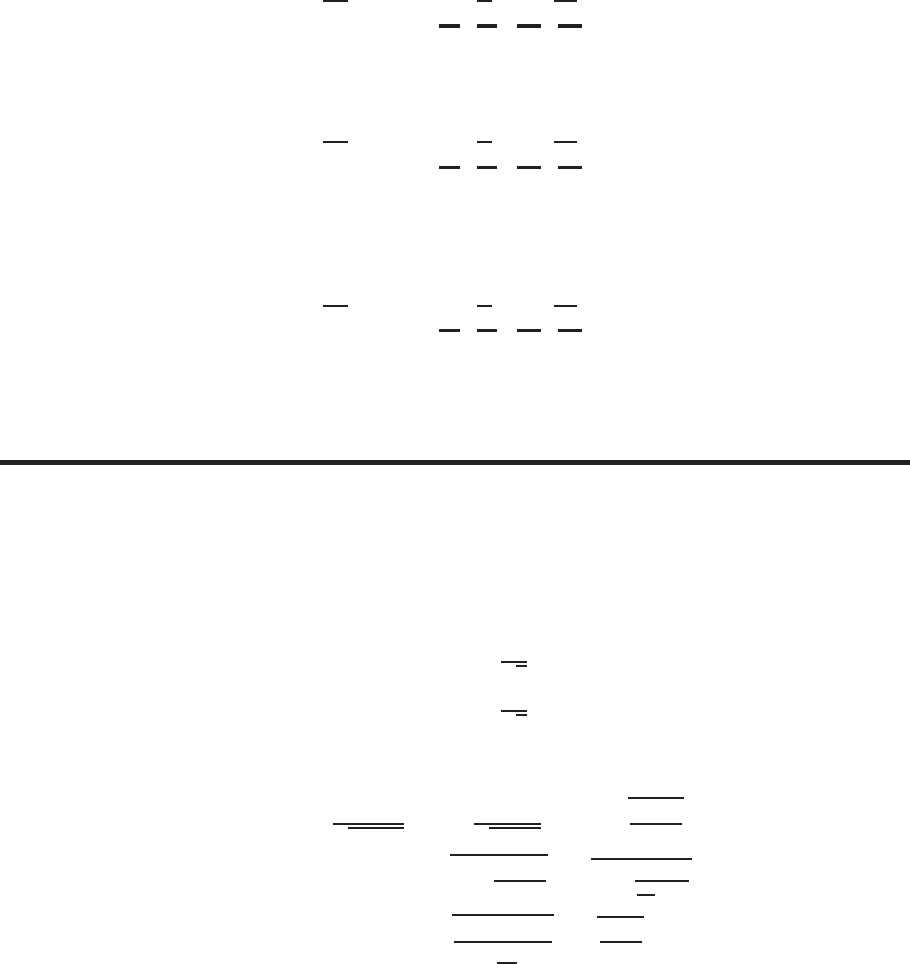
SOLUTIONS to Review Problems for Chapter Eleven 1131
55. If 0< P < L, then P/L < 1and P/(2L)<1:
dP
dt =−k
|{z}
+1−P
L
|{z }
+1−P
2L
|{z }
+
<0.
Thus, if initially there are fewer than Lanimals, dP/ dt < 0and the population will decrease.
56. If L < P < 2L, then P/L > 1and P/(2L)<1:
dP
dt =−k
|{z}
+1−P
L
| {z }
−1−P
2L
| {z }
+
>0.
Thus, if initially there are between Land 2Lanimals, dP/ dt > 0and the population will increase. Since P= 2Lis an
equilibrium solution, the population will increase towards P= 2L.
57. If P > 2L, then P/L > 1and P/(2L)>1:
dP
dt =−k
|{z}
+1−P
L
| {z }
−1−P
2L
| {z }
−
<0.
Thus, if initially there are more than 2Lanimals, dP/ dt < 0and the population will decrease. Since P= 2Lis an
equilibrium solution, the population will decrease towards P= 2L.
CAS Challenge Problems
58. (a) We find the equilibrium solutions by setting dP/dt = 0, that is, P(P−1)(2 −P) = 0, which gives three solutions,
P= 0,P= 1, and P= 2.
(b) To get your computer algebra system to check that P1and P2are solutions, substitute one of them into the equation
and form an expression consisting of the difference between the right and left hand sides, then ask the CAS to simplify
that expression. Do the same for the other function. In order to avoid too much typing, define P1and P2as functions
in your system.
(c) Substituting t= 0 gives
P1(0) = 1 −1
√4= 1/2
P2(0) = 1 + 1
√4= 3/2.
We can find the limits using a computer algebra system. Alternatively, setting u=et, we can use the limit laws to
calculate
lim
t→∞
et
√3 + e2t= lim
u→∞
u
√3 + u2= lim
u→∞ ru2
3 + u2
=rlim
u→∞
u2
3 + u2=rlim
u→∞
1
3
u2+ 1
=v
u
u
t
1
lim
u→∞
3
u2+ 1
=r1
0 + 1 = 1.
Therefore, we have
lim
t→∞ P1(t) = 1 −1 = 0
lim
t→∞ P2(t) = 1 + 1 = 2.
To predict these limits without having a formula for P, looking at the original differential equation. We see if 0<
P < 1, then P(P−1)(2 −P)<0, so P′<0. Thus, if 0< P (0) <1, then P′(0) <0, so Pis initially decreasing,
and tends toward the equilibrium solution P= 0. On the other hand, if 1< P < 2, then P(P−1)(2 −P)>0, so
P′>0. So, if 1< P (0) <2, then P′(0) >0, so Pis initially increasing and tends toward the equilibrium solution
P= 2.
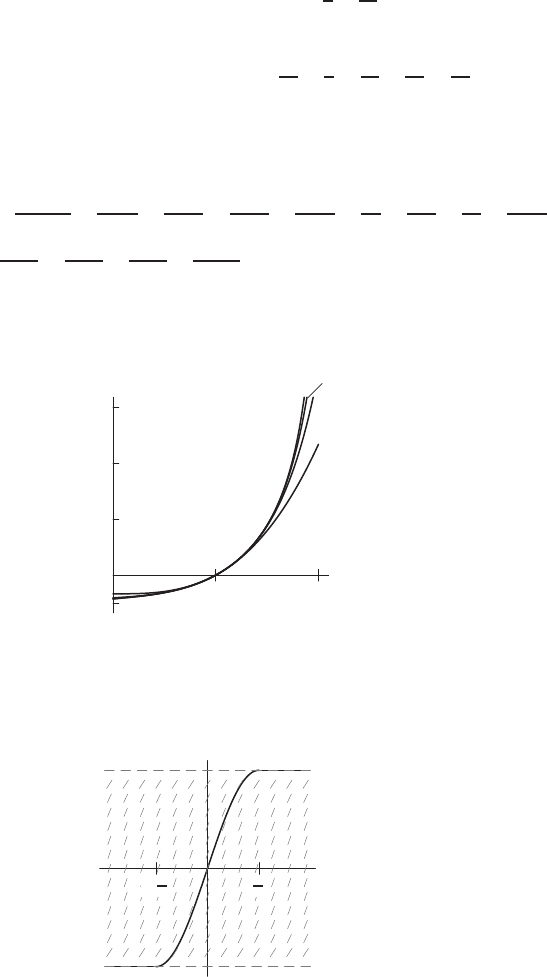
1132 Chapter Eleven /SOLUTIONS
59. (a) Using the integral equation with n+ 1 replaced by n, we have
yn(a) = b+Za
a
(yn−1(t)2+t2)dt =b+ 0 = b.
(b) We have a= 1 and b= 0, so the integral equation tells us that
yn+1(s) = Zs
1
(yn(t)2+t2)dt.
With n= 0, since y0(s) = 0, the CAS gives
y1(s) = Zs
1
0+t2dt =−1
3+s3
3.
Then
y2(s) = Zs
1
(y1(t)2+t2)dt =−17
42 +s
9+s3
3−s4
18 +s7
63 ,
and
y3(s) = Zs
1
(y2(t)2+t2)dt
=−157847
374220 +289 s
1764 −17 s2
378 +82 s3
243 −17 s4
252 +s5
42 −s6
486 +s7
63 −11 s8
1764 +
5s9
6804 +2s11
2079 −s12
6804 +s15
59535 .
(c) The solution y, and the approximations y1,y2,y3are graphed in Figure 11.111. The approximations appear to be
accurate on the range 0.5≤s≤1.5.
1 2
−0.5
1
2
3y(s)
y1(s)
y2(s)
✠y3(s)
x
y
Figure 11.111
60. (a) See Figure 11.112.
−π
2
π
2
x
y
Figure 11.112
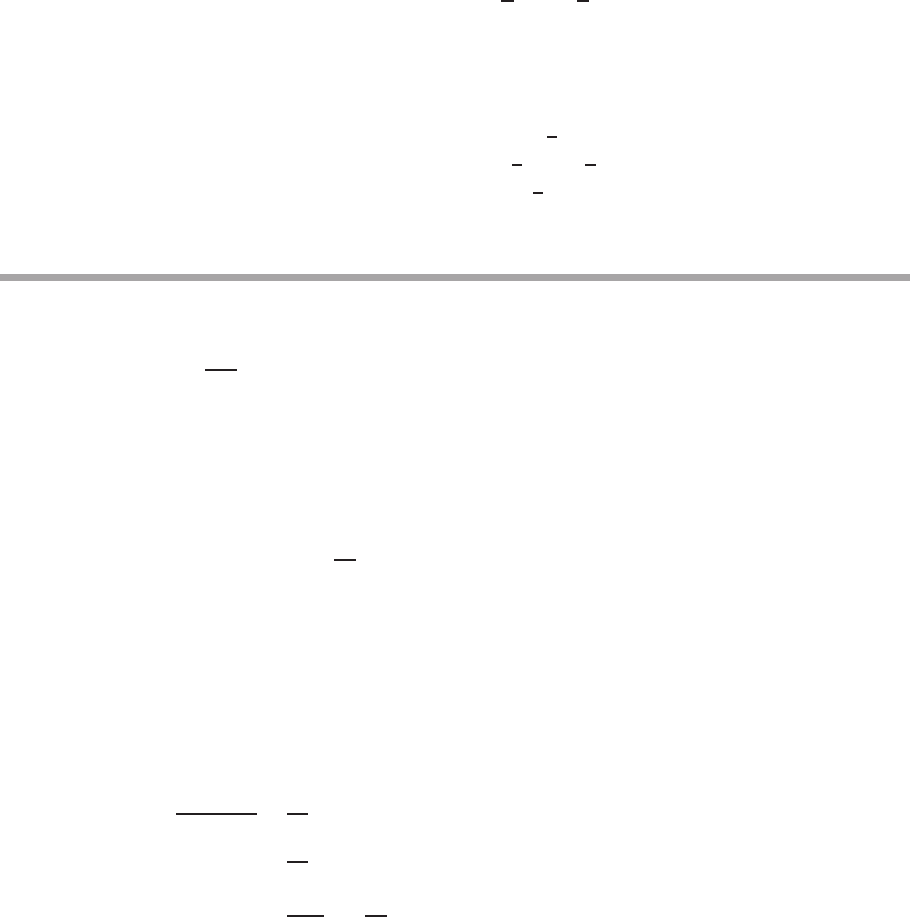
PROJECTS FOR CHAPTER ELEVEN 1133
(b) Different CASs give different answers, for example they might say y= sin x, or they might say
y= sin x, −π
2≤x≤π
2.
(c) Both the sample CAS answers in part (b) are wrong. The first one, y= sin x, is wrong because sin xstarts decreasing
at x=π/2, where the slope field clearly shows that yshould be increasing at all times. The second answer is better,
but it does not give the solution outside the range −π/2≤x≤π/2. The correct answer is the one sketched in
Figure 11.112, which has formula
y=
−1x≤−π
2
sin x−π
2≤x≤π
2
1x≤π
2≤x.
PROJECTS FOR CHAPTER ELEVEN
1. Assuming dTr/dt is proportional to Tr, we have:
dTr
dt =−kTrwhere kis a positive constant of proportionality.
The solution to this differential equation is the exponential decay function,
Tr=Ae−kt.
The solution was derived by separating variables:
Z1
Tr
dTr=Z−k dt
ln |Tr|=−kt +C
|Tr|=eCe−kt
Tr=Ae−kt.where |A|=eC.
We find the values of Aand kfrom the data in Table 11.12.We know that:
Ae−k·4= 37 since Tr=37 at t= 4
Ae−k·19.5= 13 since Tr= 13 at t= 19.5
so Ae−k·4
Ae−k·19.5=37
13 dividing
e15.5k=37
13
k=1
15.5ln 37
13= 0.06748.
Having found k, we can now find A:
Ae−0.06748(4) = 37 since Tr= 37 at t= 4
A= 48.5ng/ml.
Thus, the concentration of tryptase thours after surgery is modeled by the exponential decay function
Tr= 48.5e−0.06748tng/ml.
The greatest concentration is 48.5ng/ml, which occurs at t= 0 when the patient leaves surgery. We can
diagnose anaphylaxis since this peak level is above 45 ng/ml.

1134 Chapter Eleven /SOLUTIONS
2. (a) (i) Integrating we have
dP
dt = 30.2
P= 30.2t+C.
Since P(0) = 95, we have C= 95, so
P= 30.2t+ 95.
Substituting t= 87 and rounding to the nearest person gives
P= 30.2·87 + 95 = 2722.
The linear model predicts that 2722 people would have contracted SARS by June 12,2003.
(ii) Separating variables, we have
1
P
dP
dt = 0.12
ZdP
P=Z0.12 dt
ln |P|= 0.12t+C
P=Ae0.12t.
Since P(0) = 95, we have A= 95, so
P= 95e0.12t.
Substituting t= 87 and rounding to the nearest person gives
P= 95e0.12·87 = 3,249,062.
The exponential model predicts that 3.249 million people would have contracted SARS by June 12,
2003.
(iii) Writing the differential equation in the form
dP
dt = 0.19P−0.0002P2
dP
dt = 0.19P1−0.0002
0.19 P
dP
dt = 0.19P1−P
950,
we use the analytic solution derived on page 630 of the text to obtain
P=950
1 + Ae−0.19t,with A=950 −95
95 = 9
so
P=950
1+9e−0.19t.
Substituting t= 87 and rounding to the nearest person gives
P=950
1+9e−0.19·87 = 950.
The logistic model predicts that 950 people will have contracted SARS by June 12,2003.
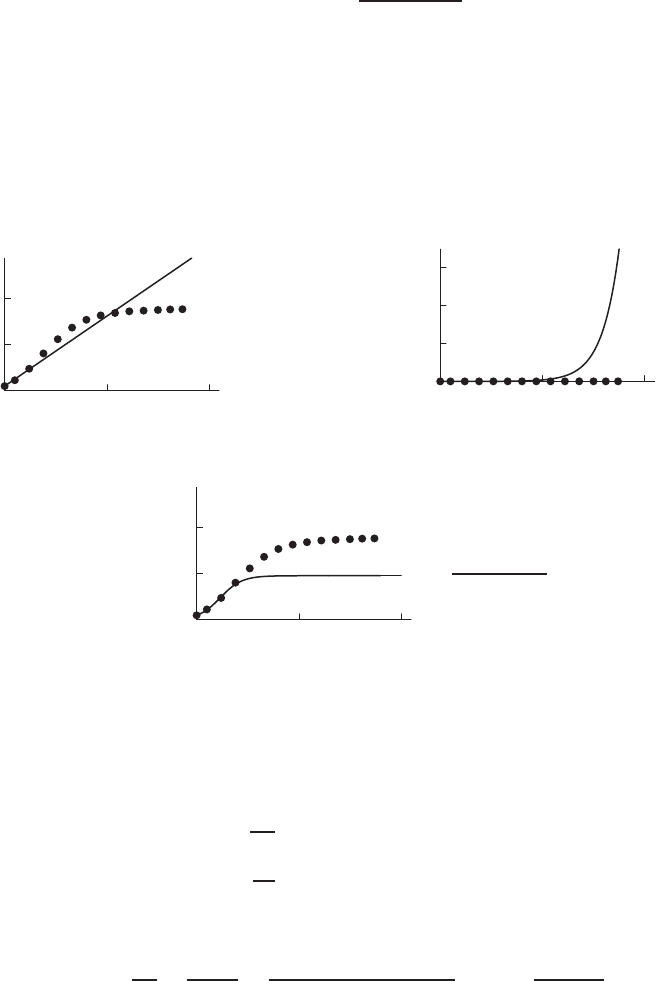
PROJECTS FOR CHAPTER ELEVEN 1135
(b) (i) The three methods give very different predictions. The linear and logistic are about 3000 and 1000,
respectively, while the exponential model is 3 million, nearly half the population of Hong Kong.
(ii) The number of new cases per day is approximated by the derivative, dP /dt. The linear model predicts
a constant number of new cases each day; the exponential model predicts an increasing number of new
cases each day; the logistic model predicts that the number of new cases per day will first increase
and then decrease.
(iii) The general trend in the figure shows that the number of new cases per day first climbed and then fell,
suggesting that the logistic model fits best. The high values are largely Mondays, and represent two
days of data recorded as one, since no new cases were reported on Sundays.
(c) (i) The formula
P=950
1+9e−0.19t
has limiting value P= 950 as t→ ∞. Thus, this formula predicts that the maximum number of cases
expected is 950.
(ii) The graph allows us to estimate (very roughly) when the daily increase was largest, namely about
April 10. Since the maximum rate of change of P(and the maximum daily increase in P) occurs at
L/2, where Lis the maximum value of P, we expect the maximum value of Pto be about 2·998 ≈
2000.
(d) See Figures 11.113–11.115. The dots represent the actual data.
50 100
1000
2000
P= 30.2t+ 95
t
(days since
March
17
)
P
Figure 11.113
:Linear predictions and actual data
50 100
1·106
2·106
3·106P= 95e0.12t
t
(days since
March
17
)
P
Figure 11.114
:Exponential predictions and actual
data
50 100
1000
2000
P=950
1 + 9e−0.19t
t
(days since
March
17
)
P
Figure 11.115
:Logistic predictions and actual data
3. (a) Since I0is the number of infecteds on day t= 0, March 17, we have I0= 95. Since S0is the initial
number of susceptibles, which is the whole population of Hong Kong, S0≈6.8million.
(b) For a= 1.25 ·10−8and b= 0.06, the system of equations is
dS
dt =−1.25 ·10−8SI
dI
dt = 1.25 ·10−8SI −0.06I.
So, by the chain rule,
dI
dS =dI/dt
dS/dt =1.25 ·10−8SI −0.06I
−1.25 ·10−8SI =−1 + 4.8·106
S.

1136 Chapter Eleven /SOLUTIONS
The slope field and trajectory are in Figure 11.116.
5·106
0.1·106
0.2·106
0.3·106
0.4·106
✠
(6.8·106,95)
S
(susceptibles)
I
(infecteds)
Figure 11.116
(c) The maximum value of Iis about 300,000; this gives us the maximum number of infecteds at any one
time—the total number of people infected during the course of the disease is much greater than this. The
trajectory meets the S-axis at about 3.3million; this tells us that when the disease dies out, there are still
3.3million susceptibles who have never had the disease. Therefore 6.8−3.3=3.5million people are
predicted to have had the disease.
The threshold value of Soccurs where dI/dt = 0 and I6= 0, so, for a= 1.25 ·10−8and b=0.06,
dI
dt = 1.25 ·10−8SI −0.06I= 0,
giving
Threshold value =S=0.06
1.25 ·10−8= 4.8·106people.
The threshold value tells us that if the initial susceptible population, S0is more than 4.8million, there will
be an epidemic. If S0is less than 4.8 million, there will not be an epidemic. Since the population of Hong
Kong is over 4.8million, an epidemic is predicted.
(d) The value of brepresents the rate at which infecteds are removed from circulation. Quarantine increases
the rate people are removed and thus increases b.
(e) For a= 1.25 ·10−8and b= 0.24, the system of differential equations is
dS
dt =−1.25 ·10−8SI
dI
dt = 1.25 ·10−8SI −0.24I.
So, by the chain rule,
dI
dS =dI/dt
dS/dt =1.25 ·10−8SI −0.24I
−1.25 ·10−8SI =−1 + 19.2·106
S.
The slope field is in Figure 11.117. The solution trajectory does not show as the disease dies out right
away.
5·106
0.1·106
0.2·106
0.3·106
0.4·106
S
(susceptibles)
I
(infecteds)
Figure 11.117
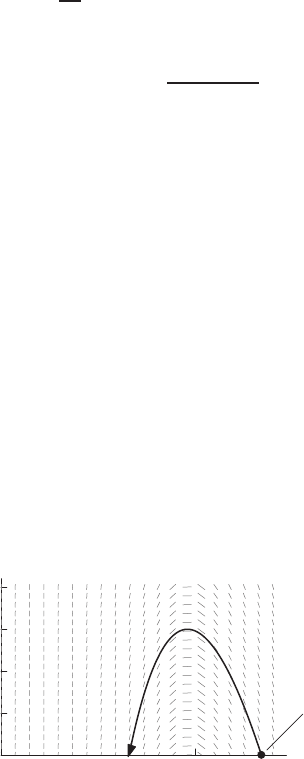
PROJECTS FOR CHAPTER ELEVEN 1137
(f) The threshold value of Soccurs where dI/dt = 0 and I6= 0, so, for b= 0.24 and the same value of a,
dI
dt = 1.25 ·10−8SI −0.24I= 0,
giving
Threshold value =S=0.24
1.25 ·10−8= 19.2·106people.
The threshold value tells us that if S0is less than 19.2 million, there will be no epidemic. The population
of Hong Kong is 6.8million, so S0is below this value. Thus no epidemic is predicted.
Policies, such as quarantine, which raise the value of bcan be effective in preventing an epidemic. In
this case, the value of bincreased sufficiently that the population of Hong Kong fell below the threshold
value, and a potential epidemic was averted. However, we do not have evidence that the quarantine policy
was responsible for the increase in b.
(g) Policy I: Closing off the city changes the initial values of S0and I0but not the values of aand b. If not
one infected person enters the city, then I0= 0 and the solution trajectory is an equilibrium point on the
S-axis. However, in practice it is almost impossible to cut off a city completely, so usually I0>0. Also,
by the time a policy to close off a city is put into effect, there may already be infected people inside the
city, so again I0>0. Thus, whether or not there is an epidemic depends on whether S0is greater than the
threshold value, not on the value of I0(provided I0>0).
For example, in the case of Hong Kong with the March values of aand b, changing the value of I0to 1
leaves the solution trajectory much as before; see Figure 11.118. The main difference is that the epidemic
occurs slightly later. So a policy of isolating a city only works if it keeps the disease out of the city of the
city entirely. Thus, Policy I does not help the city except in the exceptional case that every infected person
is kept out.
5·106
0.1·106
0.2·106
0.3·106
0.4·106
✠
(6.8·106,1)
S
(susceptibles)
I
(infecteds)
Figure 11.118
Policy II: From the analysis of the Hong Kong data, we see that a quarantine policy can help prevent
an epidemic if the value of bis increased enough to bring S0below the threshold value. Thus, Policy II
can be very effective.
4. (a)
p(x) = the number of people with incomes ≥x.
p(x+ ∆x) = the number of people with incomes ≥x+ ∆x.
So the number of people with incomes between xand x+ ∆xis
p(x)−p(x+ ∆x) = −∆p.
Since all the people with incomes between xand x+ ∆xhave incomes of about x(if ∆xis small),
the total amount of money earned by people in this income bracket is approximately x(−∆p) = −x∆p.
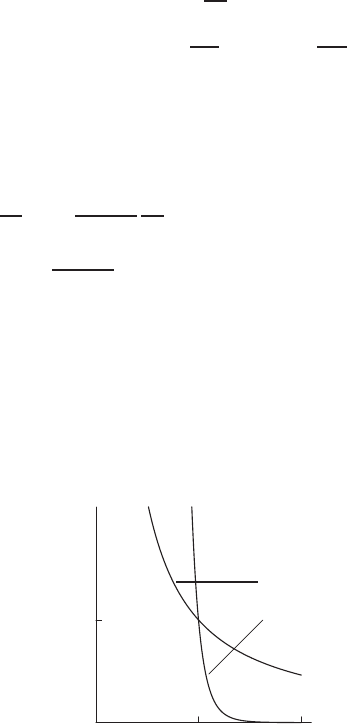
1138 Chapter Eleven /SOLUTIONS
(b) Pareto’s law claims that the average income of all the people with incomes ≥xis kx. Since there are p(x)
people with income ≥x, the total amount of money earned by people in this group is kxp(x).
The total amount of money earned by people with incomes ≥(x+ ∆x)is therefore k(x+ ∆x)p(x+
∆x). Then the total amount of money earned by people with incomes between xand x+ ∆xis
kxp(x)−k(x+ ∆x)p(x+ ∆x).
Since ∆p=p(x+ ∆x)−p(x),we can substitute p(x+ ∆x) = p(x) + ∆p. Thus the total amount of
money earned by people with incomes between xand x+ ∆xis
kxp(x)−k(x+ ∆x)(p(x) + ∆p).
Multiplying out, we have
kxp(x)−kxp(x)−k(∆x)p(x)−kx∆p−k∆x∆p
Simplifying and dropping the second order term ∆x∆pgives the total amount of money earned by people
with incomes between xand x+ ∆xas
−kp∆x−kx∆p.
(c) Setting the answers to parts (a) and (b) equal gives
−x∆p=−kp∆x−kx∆p.
Dividing by ∆x, and letting ∆x→0so that ∆p
∆x→p′, we have
x∆p
∆x=kp +kx ∆p
∆x
xp′=kp +kxp′
so
(1 −k)xp′=kp.
(d) We solve this equation by separating variables
Zdp
p=Zk
(1 −k)
dx
x
ln p=k
(1 −k)ln x+C(no absolute values needed since p,x > 0)
ln p= ln xk/(1−k)+ ln A(writing C= ln A)
ln p= ln[Axk/(1−k)](using ln(AB) = ln A+ ln B)
p=Axk/(1−k)
(e) We take A= 1. For k= 10,p=x−10/9≈x−1. For k=1.1,p=x−11. The functions are graphed in
Figure 11.119. Notice that the larger the value of k, the less negative the value of k/(1 −k)(remember
k > 1), and the slower p(x)→0as x→ ∞.
1 2
1
x
p(x)
x−10/9(k= 10)
x−11 (k= 1.1)
✛
✠
Figure 11.119
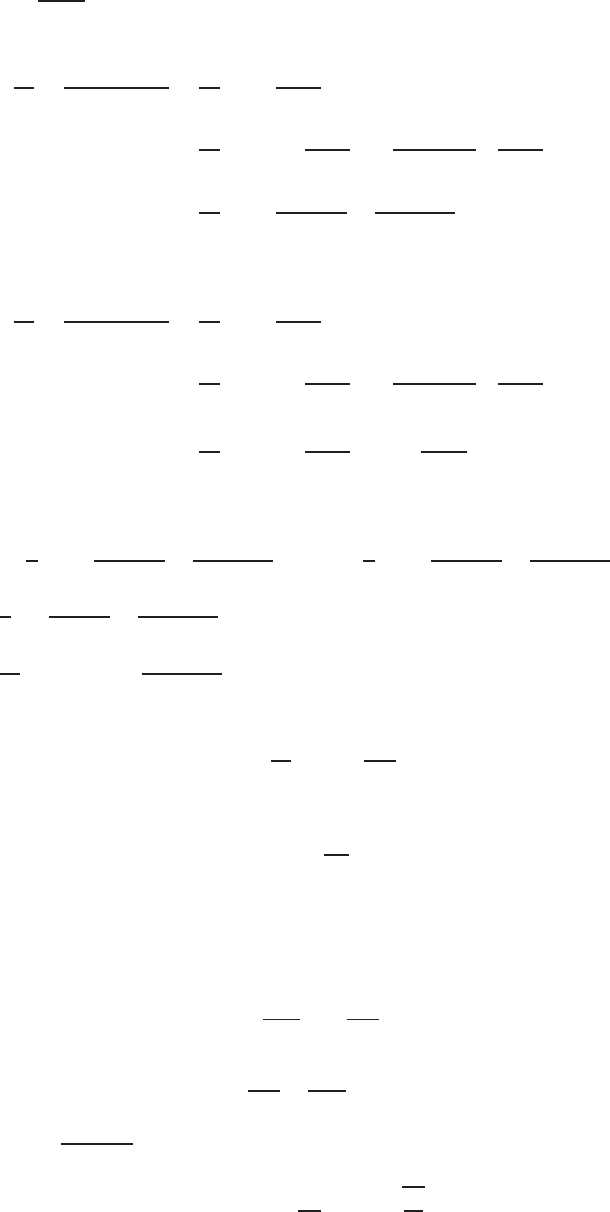
PROJECTS FOR CHAPTER ELEVEN 1139
5. (a) Writing F=ba2−ar
r3= 0 shows F= 0 when r=a, so r=agives the equilibrium position.
(b) Expanding 1/r3about r=agives
1
r3=1
(a+r−a)3=1
a31 + r−a
a−3
=1
a3 1−3r−a
a+(−3)(−4)
2! r−a
a2
− ···!
=1
a31−3(r−a)
a+6(r−a)2
a2− ···.
Similarly, expanding 1/r2about r=agives
1
r2=1
(a+r−a)2=1
a21+r−a
a−2
=1
a2 1−2r−a
a+(−2)(−3)
2! r−a
a2
− ···!
=1
a2 1−2r−a
a+ 3 r−a
a2
− ···!.
Thus, combining gives
F=b1
a1−3(r−a)
a+6(r−a)2
a2− ···−1
a1−2(r−a)
a+3(r−a)2
a2− ···
=b
a−(r−a)
a+3(r−a)2
a2− ···
=b
a2−(r−a) + 3(r−a)2
a− ···.
(c) Setting x=r−agives
F≈b
a2−x+3x2
a.
(d) For small x, we discard the quadratic term in part (c), giving
F≈−b
a2x.
The acceleration is d2x/dt2. Thus, using Newton’s Second Law:
Force =Mass ·Acceleration
we get
−bx
a2=md2x
dt2.
So d2x
dt2+b
a2mx= 0.
This differential equation represents an oscillation of the form x=C1cos ωt +C2sin ωt, where ω2=
b/(a2m)soω=pb/(a2m). Thus, we have
Period =2π
ω= 2πarm
b.

12.1 SOLUTIONS 1141
CHAPTER TWELVE
Solutions for Section 12.1
Exercises
1. The point Pis √12+ 22+ 12=√6 = 2.45 units from the origin, and Qis √22+ 02+ 02= 2 units from the origin.
Since 2<√6, the point Qis closer.
2. The distance formula: d=p(x2−x1)2+ (y2−y1)2+ (z2−z1)2gives us the distance between any pair of points
(x1, y1, z1)and (x2, y2, z2). Thus, we find
Distance from P1to P2= 2√2
Distance from P2to P3=√6
Distance from P1to P3=√10
So P2and P3are closest to each other.
3. The distance of a point P= (x, y, z)from the yz-plane is |x|, from the xz-plane is |y|, and from the xy-plane is |z|.
So, Bis closest to the yz-plane, since it has the smallest x-coordinate in absolute value. Blies on the xz-plane, since its
y-coordinate is 0.Bis farthest from the xy-plane, since it has the largest z-coordinate in absolute value.
4. Your final position is (1,−1,1). This places you in front of the yz-plane, to the left of the xz-plane, and above the
xy-plane.
5. An example is the line y=zin the yz-plane. See Figure 12.1.
xy
z
Figure 12.1
6. The midpoint is found by averaging coordinates:
Midpoint =−1+ 5
2,3 + 6
2,9−3
2= (2,4.5,3).
7. The graph is a horizontal plane at height 4 above the xy-plane. See Figure 12.2.

1142 Chapter Twelve /SOLUTIONS
x
y
z
Figure 12.2
8. The graph is a plane parallel to the yz-plane, and passing through the point (−3,0,0). See Figure 12.3.
31 x
y
z
x=−3
−3
Figure 12.3
9. The graph is a plane parallel to the xz-plane, and passing through the point (0,1,0). See Figure 12.4.
x
y
z
y= 1
1
Figure 12.4
10. The graph is all points with y= 4 and z= 2, i.e., a line parallel to the x-axis and passing through the points
(0,4,2); (2,4,2); (4,4,2) etc. See Figure 12.5.
z
x
y
2
4
(0,4,2)
(2,4,2)
(4,4,2)
Figure 12.5
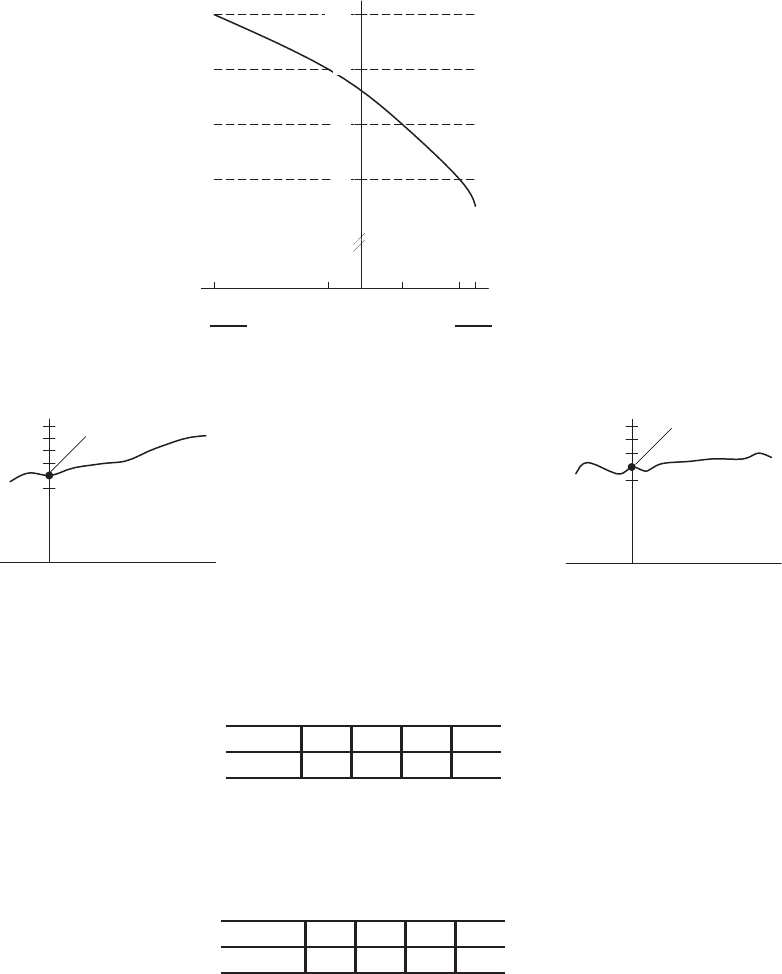
12.1 SOLUTIONS 1143
11. The radius is 7−(−1) = 8, so the highest point is at (2,3,15).
12. The equation is x2+y2+z2= 25
13. The sphere has equation (x−1)2+y2+z2= 4.
14. The plane has equation y= 3.
15. (a) 80-90◦F
(b) 60-72◦F
(c) 60-100◦F
16.
✲
north
✛
south
100
90
80
70
Topeka
distance from
Topeka
predicted high temperature
Figure 12.6
17.
North South
60
80
100
✠
Boise
Figure 12.7
West East
60
80
100
✠
Boise
Figure 12.8
18. Beef consumption by households making $20,000/year is given by Row 1 of Table 12.1 on page 667 of the text.
Table 12.1
p3.00 3.50 4.00 4.50
f(20, p) 2.65 2.59 2.51 2.43
For households making $20,000/year, beef consumption decreases as price goes up.
Beef consumption by households making $100,000/year is given by Row 5 of Table 12.1.
Table 12.2
p3.00 3.50 4.00 4.50
f(100, p) 5.79 5.77 5.60 5.53
For households making $100,000/year, beef consumption also decreases as price goes up.
Beef consumption by households when the price of beef is $3.00/lb is given by Column 1 of Table 12.1.
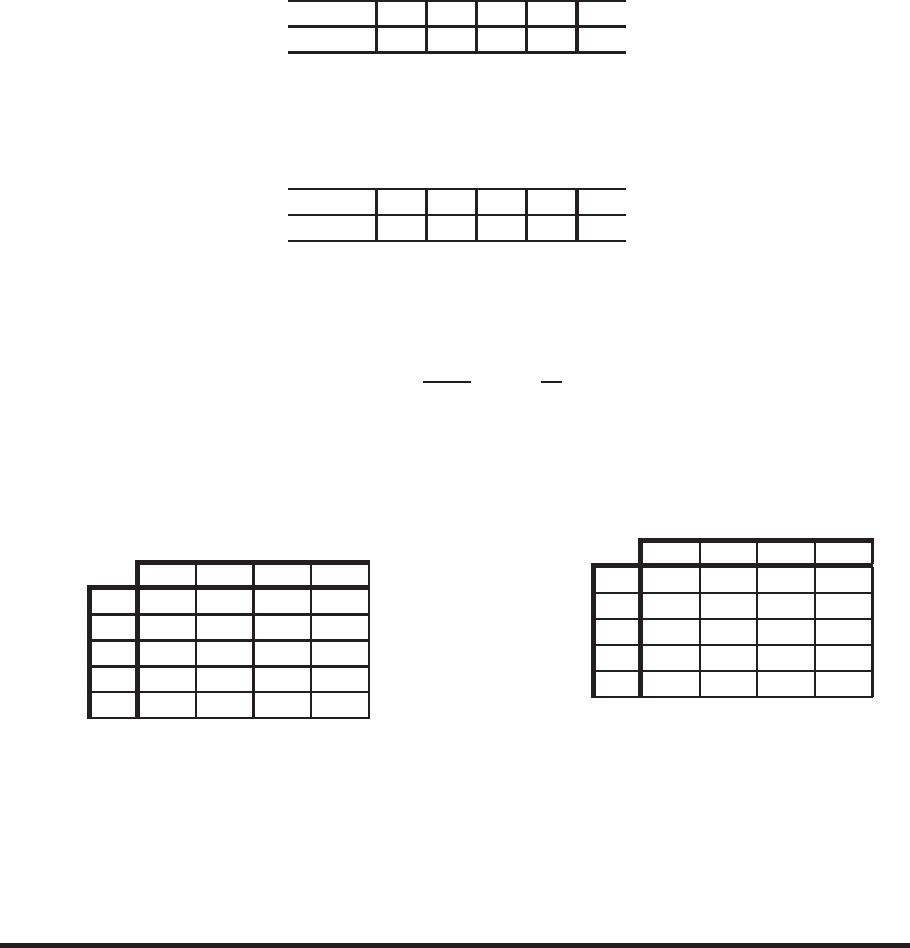
1144 Chapter Twelve /SOLUTIONS
Table 12.3
I20 40 60 80 100
f(I, 3.00) 2.65 4.14 5.11 5.35 5.79
When the price of beef is $3.00/lb, beef consumption increases as income increases.
Beef consumption by households when the price of beef is $4.00/lb is given by Column 3 of Table 12.1.
Table 12.4
I20 40 60 80 100
f(I, 4.00) 2.51 3.94 4.97 5.19 5.60
When the price of beef is $4.00/lb, beef consumption increases as income increases.
19. Table 12.5 gives the amount Mspent on beef per household per week. Thus, the amount the household spent on beef in a
year is 52M. Since the household’s annual income is Ithousand dollars, the proportion of income spent on beef is
P=52M
1000I= 0.052 M
I.
Thus, we need to take each entry in Table 12.5, divide it by the income at the left, and multiply by 0.052. Table 12.6 shows
the results.
Table 12.5
Money spent on beef
($/household/week)
Income
($1,000)
Price of Beef ($)
3.00 3.50 4.00 4.50
20 7.95 9.07 10.04 10.94
40 12.42 14.18 15.76 17.46
60 15.33 17.50 19.88 21.78
80 16.05 18.52 20.76 22.82
100 17.37 20.20 22.40 24.89
Table 12.6
Proportion of annual income spent on beef
Income
($1,000)
Price of Beef ($)
3.00 3.50 4.00 4.50
20 0.021 0.024 0.026 0.028
40 0.016 0.018 0.020 0.023
60 0.013 0.015 0.017 0.019
80 0.010 0.012 0.013 0.015
100 0.009 0.011 0.012 0.013
20. If the price of beef is held constant, beef consumption for households with various incomes can be read from a fixed
column in Table 12.1 on page 667 of the text. For example, the column corresponding to p= 3.00 gives the function
h(I) = f(I, 3.00); it tells you how much beef a household with income Iwill buy at $3.00/lb. Looking at the column
from the top down, you can see that it is an increasing function of I. This is true in every column. This says that at any
fixed price for beef, consumption goes up as household income goes up—which makes sense. Thus, fis an increasing
function of Ifor each value of p.
Problems
21. (a) According to Table 12.2 of the problem, it feels like −19◦F.
(b) A wind of 20 mph, according to Table 12.2.
(c) About 17.5mph. Since at a temperature of 25◦F, when the wind increases from 15 mph to 20 mph, the temperature
adjusted for wind chill decreases from 13◦F to 11◦F, we can say that a 5 mph increase in wind speed causes a 2◦F
decrease in the temperature adjusted for wind chill. Thus, each 2.5mph increase in wind speed brings about a1◦F
drop in the temperature adjusted for wind chill. If the wind speed at 25◦F increases from 15 mph to 17.5mph, then
the temperature you feel will be 13 −1 = 12◦F.
(d) Table 12.2 shows that with wind speed 20 mph the temperature will feel like 0◦F when the air temperature is some-
where between 15◦F and 20◦F. When the air temperature drops 5◦F from 20◦F to 15◦F, the temperature adjusted for
wind-chill drops 6◦F from 4◦F to −2◦F. We can say that for every 1◦F decrease in air temperature there is about a
6/5 = 1.2◦F drop in the temperature you feel. To drop the temperature you feel from 4◦F to 0◦F will take an air
temperature drop of about 4/1.2 = 3.3◦F from 20◦F. With a wind of 20 mph, approximately 20 −3.3 = 16.7◦F
would feel like 0◦F.
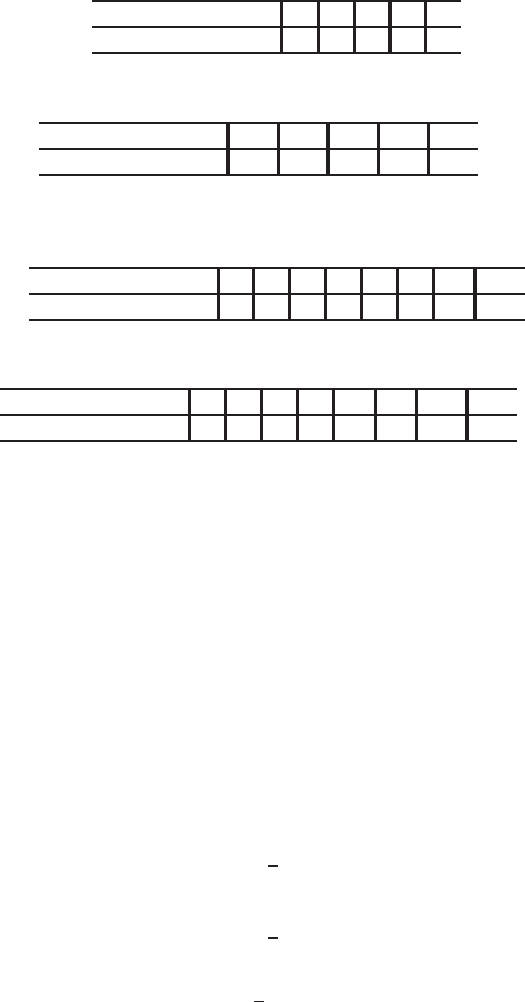
12.1 SOLUTIONS 1145
22.
Table 12.7
Temperature adjusted for wind chill at
20◦F
Wind speed (mph) 5 10 15 20 25
Adjusted temperature (◦F) 13 9 6 4 3
Table 12.8
Temperature adjusted for wind chill at 0◦F
Wind speed (mph) 5 10 15 20 25
Adjusted temperature (◦F) −11 −16 −19 −22 −24
23.
Table 12.9
Temperature adjusted for wind chill at 5 mph
Temperature (◦F) 35 30 25 20 15 10 5 0
Adjusted temperature (◦F) 31 25 19 13 7 1 −5−11
Table 12.10
Temperature adjusted for wind chill at 20 mph
Temperature (◦F) 35 30 25 20 15 10 5 0
Adjusted temperature (◦F) 24 17 11 4 −2−9−15 −22
24. (a) The total cost in dollars of renting a car is 40 times the number of days plus 0.15 times the number of miles driven,
so
C=f(d, m) = 40d+ 0.15m.
(b) We have
f(5,300) = 40(5) + 0.15(300) = $245.
Renting a car for 5 days and driving it 300 miles costs $245.
25. The gravitational force on a 100 kg object which is 7,000,000 meters from the center of the earth (or about 600 km above
the earth’s surface) is about 820 newtons.
26. (a) The acceleration due to gravity decreases as hincreases, because the gravitational force gets weaker the farther away
you are from the planet. (In fact, gis inversely proportional to the square of the distance from the center of the planet.)
(b) The acceleration due to gravity increases as mincreases. The more massive the planet, the larger the gravitational
force. (In fact, gis proportional to m.)
27. By drawing the top four corners, we find that the length of the edge of the cube is 5. See Figure 12.9. We also notice that
the edges of the cube are parallel to the coordinate axis. So the x-coordinate of the the center equals
−1 + 5
2= 1.5.
The y-coordinate of the center equals
−2 + 5
2= 0.5.
The z-coordinate of the center equals
2−5
2=−0.5.
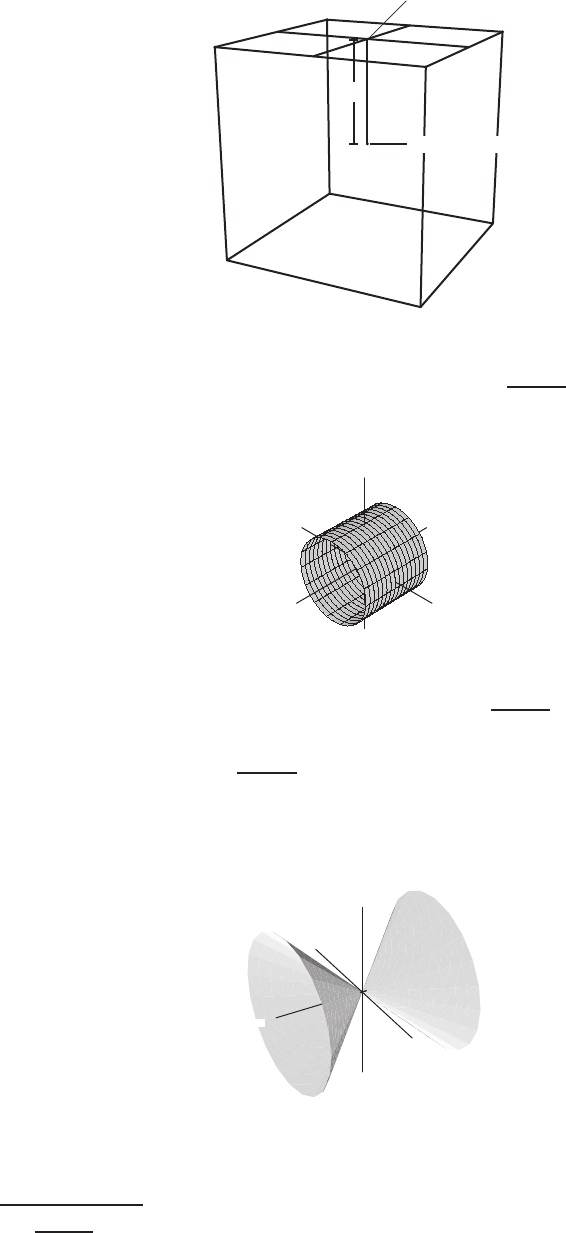
1146 Chapter Twelve /SOLUTIONS
✠
(1.5,0.5,2)
(4,−2,2)
(−1,−2,2)
(−1,3,2)
(4,3,2)
✻
❄
2.5
✛(1.5,0.5,−0.5)
Figure 12.9
28. The equation for the points whose distance from the x-axis is 2 is given by py2+z2= 2, i.e. y2+z2= 4. It specifies
a cylinder of radius 2 along the x-axis. See Figure 12.10.
xy
z
Figure 12.10
29. The distance of any point with coordinates (x, y, z)from the x-axis is py2+z2. The distance of the point from the
xy-plane is |x|. Since the condition states that these distances are equal, the equation for the condition is
py2+z2=|x|i.e. y2+z2=x2.
This is the equation of a cone whose tip is at the origin and which opens along the x-axis with a slope of 1 as shown in
Figure 12.11.
x
y
z
Figure 12.11
30. The coordinates of points on the y-axis are (0, y, 0). The distance from any such point (0, y, 0) to the point (a, b, c)is
d=pa2+ (b−y)2+c2. Therefore, the closest point will have y=bin order to minimize d. The resulting distance is
then: d=√a2+c2.
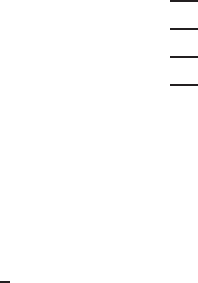
12.1 SOLUTIONS 1147
31. (a) The sphere has center at (2,3,3) and radius 4. The planes parallel to the xy-plane just touching the sphere are 4
above and 4 below the center. Thus, the planes z= 7 and z=−1are both parallel to the xy-plane and touch the
sphere at the points (2,3,7) and (2,3,−1).
(b) The planes x= 6 and x=−2just touch the sphere at (6,3,3) and at (−2,3,3) respectively and are parallel to the
yz-plane.
(c) The planes y= 7 and y=−1just touch the sphere at (2,7,3) and at (2,−1,3) respectively and are parallel to the
xz-plane.
32. The edges of the cube have length 4. Thus, the center of the sphere is the center of the cube which is the point (4,7,1)
and the radius is r= 2.Thus an equation of this sphere is
(x−4)2+ (y−7)2+ (z−1)2= 4.
33. (a) The vertex at the opposite end of a diagonal across the base is (12,7,2). The other two points are (5,7,2) and
(12,1,2).
(b) The vertex at the opposite end of a diagonal across the top is (5,1,4). The other two points are (5,7,4) and (12,1,4).
34. Using the distance formula, we find that
Distance from P1to P=√206
Distance from P2to P=√152
Distance from P3to P=√170
Distance from P4to P=√113
So P4= (−4,2,7) is closest to P= (6,0,4).
35. (a) To find the intersection of the sphere with the yz-plane, substitute x= 0 into the equation of the sphere:
(−1)2+ (y+ 3)2+ (z−2)2= 4,
therefore
(y+ 3)2+ (z−2)2= 3
This equation represents a circle of radius √3.
On the xz-plane y= 0:
(x−1)2+ 32+ (z−2)2= 4,
therefore
(x−1)2+ (z−2)2=−5
The negative sign on the right side of this equation shows that the sphere does not intersect the xz-plane, since the
left side of the equation is always non-negative.
On the xy-plane, z= 0:
(x−1)2+ (y+ 3)2+ (−2)2= 4,
therefore
(x−1)2+ (y+ 3)2= 0.
This equation has the unique solution x= 1,y=−3, so the xy-plane intersects the sphere in the single point
(1,−3,0).
(b) Since the sphere does not intersect the xz-plane, it cannot intersect the xor zaxes. On the y-axis, we have x=z= 0.
Substituting this into the equation for the sphere we get
(−1)2+ (y+ 3)2+ (−2)2= 4,
therefore
(y+ 3)2=−1.
This equation has no solutions because the right hand side is negative, and the left-hand side is always non-negative.
Thus the sphere does not intersect any of the coordinate axes.
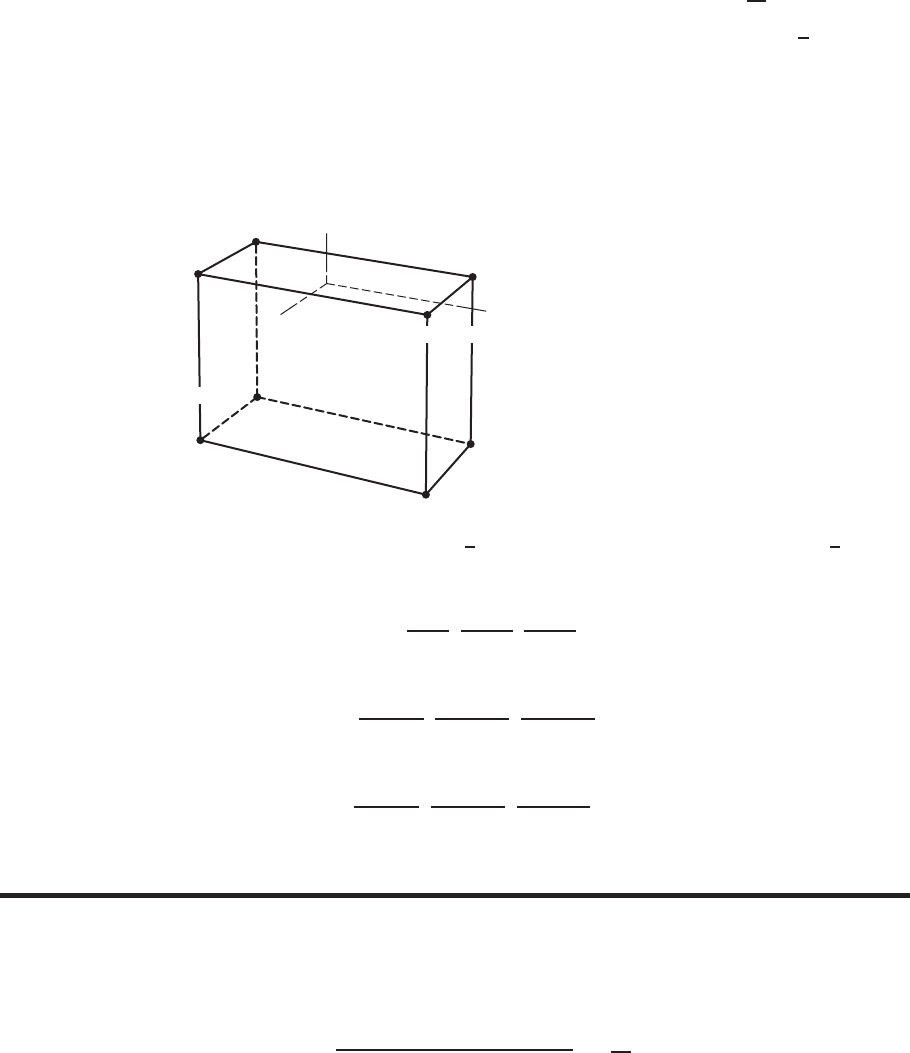
1148 Chapter Twelve /SOLUTIONS
36. The length corresponds to the y-axis, therefore the y-coordinates of the corners must be 1±13
2=−5.5,7.5. See
Figure 12.12. The height corresponds to the z-axis, therefore the z-coordinates of the corners must be −2±5
2= 0.5,−4.5.
The width corresponds to the x-axis, therefore the x-coordinates of the corners must be 1±3 = 4,−2. The coordinates
of those eight corners are therefore
(4,7.5,0.5),(−2,7.5,0.5),(−2,−5.5,0.5),(4,−5.5,0.5),
(4,7.5,−4.5),(−2,7.5,−4.5),(−2,−5.5,−4.5),(4,−5.5,−4.5).
(−2,7.5,0.5)
(−2,7.5,−4.5)
(4,7.5,−4.5)
(4,7.5,0.5)
(4,−5.5,−4.5)
(−2,−5.5,−4.5)
(4,−5.5,0.5)
(−2,−5.5,0.5)
xy
z
Figure 12.12
37. The length of the side of the triangle is 2, so its height is √3. The coordinates of the highest point are (8,0,√3).
38. (a) We find the midpoint by averaging
Midpoint =1 + 5
2,5 + 13
2,7 + 19
2= (3,9,13).
(b) We use a weighted average, with the coordinates of point Aweighted three times more heavily than point B:
Point =3·1 + 5
4,3·5 + 13
4,3·7 + 19
4= (2,7,10).
(c) We find the point in a similar way to part (b), but weighting Bmore heavily
Point =1 + 3 ·5
4,5 + 3 ·13
4,7 + 3 ·19
4= (4,11,16).
Strengthen Your Understanding
39. The graph of the equation y= 1 is a plane perpendicular to the y-axis, not a line. The x-axis is parallel to the plane.
40. The xy-plane has equation z= 0,
The equation xy = 0 means either x= 0 (the equation of the yz-plane) or y= 0 (the equation of the xz-plane).
Points on the xy-plane all have z= 0; this is its equation.
41. The closest point on the x-axis to (2,3,4) is (2,0,0). The distance from (2,3,4) to this point is
d=p(2 −2)2+ (3 −0)2+ (4 −0)2=√25 = 5.
42. One possible function that is increasing in xand decreasing in yis given by the formula f(x, y) = x−y. For a fixed value
of x, the value of x−ydecreases as yincreases, and for a fixed value of y, the value of x−yincreases as xincreases.
There are many other possible answers.
43. If we pick a point with z=−5, its distance from the plane z=−5is zero. The distance of a point from the xz-plane is
the magnitude of the y-coordinate. So the point (−2,−1,−5) is a distance of 1 from the xz-plane and a distance of zero
from the plane z=−5. There are many other possible points.
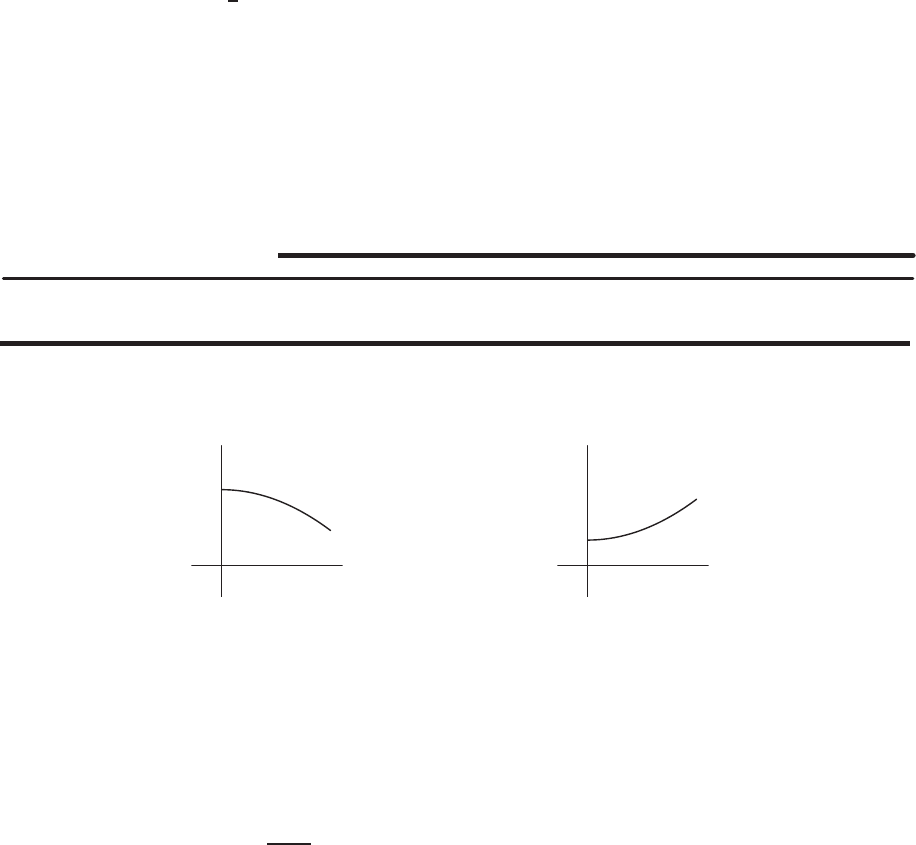
12.2 SOLUTIONS 1149
44. True. Since each choice of xand ydetermines a unique value for f(x, y), choosing x= 10 yields a unique value of
f(10, y)for any choice of y.
45. True. Since each choice of h > 0and s > 0determines a unique value for the volume V, we can say Vis a function of h
and s. In fact, this function has a formula: V(h, s) = h·s2.
46. False. If, for example, d= 2 meters and H= 57◦C, there could be many times tat which the water temperature is 57 ◦C
at 2meters depth.
47. False. A function may have different inputs that yield equal outputs.
48. True. Since each of f(x)and g(y)has at most one output for each input, so does their product.
49. True. All points in the z= 2 plane have z-coordinate 2, hence are below any point of the form (a, b, 3).
50. False. The plane z= 2 is parallel to the xy-plane.
51. True. Both are distance √2from the origin.
52. False. The point (2,−1,3) does not satisfy the equation. It is at the center of the sphere, and does not lie on the graph.
53. True. The origin is the closest point in the yz-plane to the point (3,0,0), and its distance to (3,0,0) is 3.
54. False. There is an entire circle (of radius 4) of points in the yz-plane that are distance 5 from (3,0,0).
55. False. The value of bcan be ±4.
56. True. Otherwise fwould have more than one value for a given pair (x, y), which cannot happen if fis a function.
57. False. For example, the y-axis intersects the graph of f(x, y) = 1 −x2−y2twice, at y=±1.
Solutions for Section 12.2
Exercises
1. (a) The value of zdecreases as xincreases. See Figure 12.13.
(b) The value of zincreases as yincreases. See Figure 12.14.
x
z
Figure 12.13
y
z
Figure 12.14
2. (a) is (IV), since z= 2 + x2+y2is a paraboloid opening upward with a positive z-intercept.
(b) is (II), since z= 2 −x2−y2is a paraboloid opening downward.
(c) is (I), since z= 2(x2+y2)is a paraboloid opening upward and going through the origin.
(d) is (V), since z= 2 + 2x−yis a slanted plane.
(e) is (III), since z= 2 is a horizontal plane.
3. (a) The value of zonly depends on the distance from the point (x, y)to the origin. Therefore the graph has a circular
symmetry around the z-axis. There are two such graphs among those depicted in the figure in the text: I and V. The
one corresponding to z=1
x2+y2is I since the function blows up as (x, y)gets close to (0,0).
(b) For similar reasons as in part (a), the graph is circularly symmetric about the z-axis, hence the corresponding one
must be V.
(c) The graph has to be a plane, hence IV.
(d) The function is independent of x, hence the corresponding graph can only be II. Notice that the cross-sections of this
graph parallel to the yz-plane are parabolas, which is a confirmation of the result.
(e) The graph of this function is depicted in III. The picture shows the cross-sections parallel to the zx-plane, which have
the shape of the cubic curves z=x3−constant.

1150 Chapter Twelve /SOLUTIONS
4. The graph is a horizontal plane 3 units above the xy-plane. See Figure 12.15.
1
xy
z
Figure 12.15
5. The graph is a sphere of radius 3, centered at the origin. See Figure 12.16.
33
3
xy
z
Figure 12.16
6. The graph is a bowl opening up, with vertex at the point (0,0,4). See Figure 12.17.
4
xy
z
Figure 12.17
7. Since z= 5−(x2+y2), the graph is an upside-down bowl moved up 5 units and with vertex at (0,0,5). See Figure 12.18.
5
x
y
z
Figure 12.18

12.2 SOLUTIONS 1151
8. In the yz-plane, the graph is a parabola opening up. Since there are no restrictions on x, we extend this parabola along the
x-axis. The graph is a parabolic cylinder opening up, extended along the x-axis. See Figure 12.19.
x
y
z
Figure 12.19
9. The graph is a plane with x-intercept 6, and y-intercept 3, and z-intercept 4. See Figure 12.20.
63
4
xy
z
Figure 12.20
10. In the xy-plane, the graph is a circle of radius 2. Since there are no restrictions on z, we extend this circle along the z-axis.
The graph is a circular cylinder extended in the z-direction. See Figure 12.21.
xy
z
Figure 12.21
11. In the xz-plane, the graph is a circle of radius 2. Since there are no restrictions on y, we extend this circle along the y-axis.
The graph is a circular cylinder extended in the y-direction. See Figure 12.22.
2
2
xy
z
Figure 12.22
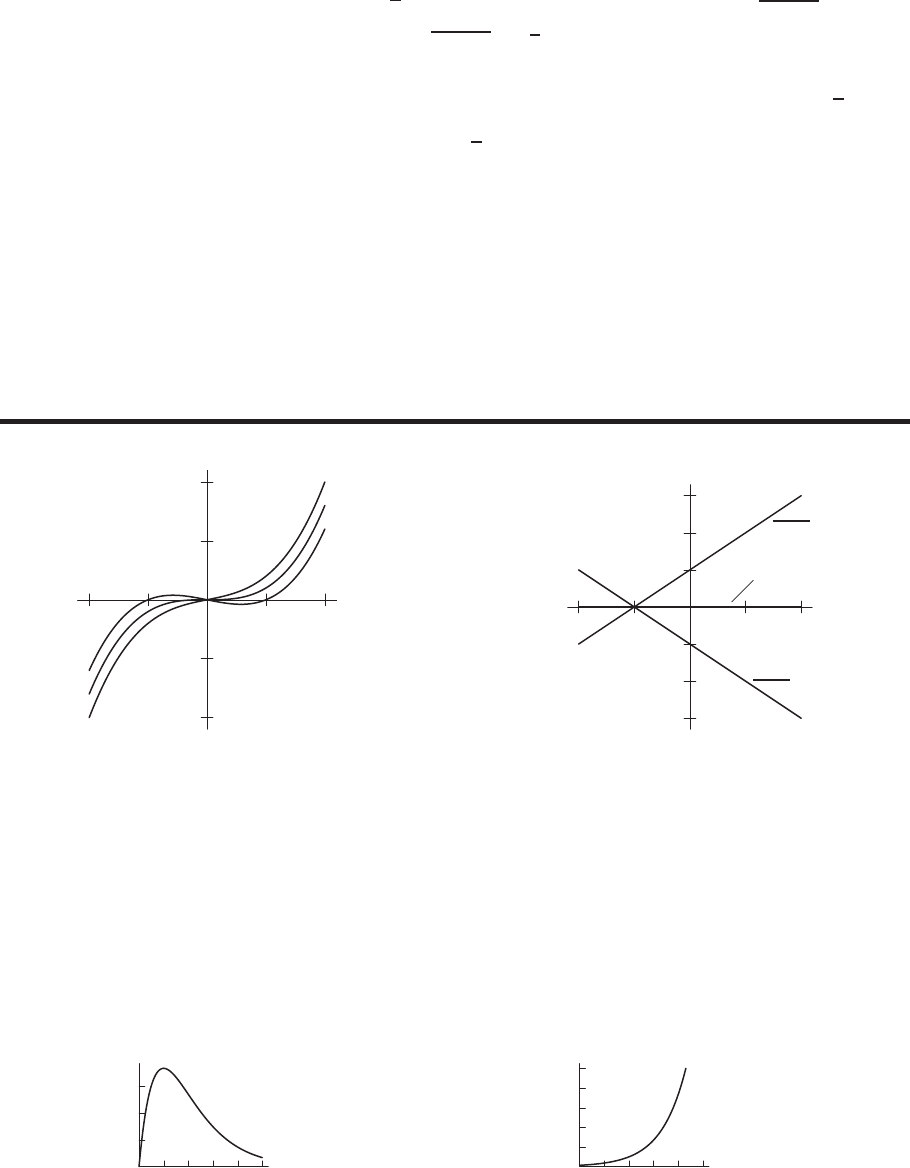
1152 Chapter Twelve /SOLUTIONS
12. All the points on the cylinder are at a distance √7from the y-axis. Since this distance is given by √x2+z2, we have
px2+z2=√7
x2+z2= 7.
13. A sphere of radius 3 centered at the origin has equation x2+y2+z2= 32= 9, so shifting the center to (0.√7,0) gives
x2+ (y−√7)2+z2= 9.
14. A paraboloid with vertex at the origin but opening along the positive x-axis is
x=y2+z2.
A parabola opening toward the negative x-axis is
x=−y2−z2
so moving the vertex to (1,3,5) gives
x= 1 −(y−3)2−(z−5)2.
Problems
15. (a) Cross-sections with xfixed at x=bare in Figure 12.23.
−1
1−2 2
−5
5
−10
10 x= 1
x= 0
x=−1
y
Figure 12.23
: Cross-section
f(a, y) = y3+ay, with a=−1,0,1
−2−1 1 2
−3
−2
−1
1
2
3✛y= 1
✛y=−1
✠
y= 0
x
Figure 12.24
: Cross-section
f(x, b) = b3+bx, with b=−1,0,1
(b) Cross-section with yfixed at y= 6 are in Figure 12.24.
16. We have f(3,2) = 2e−2(5−3) = 0.037. We see that 2 hours after the injection of 3 mg of this drug, the concentration of
the drug in the blood is 0.037 mg per liter.
17. (a) Holding xfixed at 4 means that we are considering an injection of 4 mg of the drug; letting tvary means we are
watching the effect of this dose as time passes. Thus the function f(4, t)describes the concentration of the drug in
the blood resulting from a 4 mg injection as a function of time. Figure 12.25 shows the graph of f(4, t) = te−t.
Notice that the concentration in the blood from this dose is at a maximum at 1 hour after injection, and that the
concentration in the blood eventually approaches zero.
1 2 3 4 5
0.1
0.2
0.3C=f(4, t)
C
(mg per liter)
t
(hours)
Figure 12.25
: The function f(4, t)
shows the concentration in the blood
resulting from a 4 mg injection
12345
0.1
0.2
0.3
0.4
0.5
C=f(x, 1)
x
(mg)
C
(mg per liter)
Figure 12.26
: The function f(x, 1)
shows the concentration in the blood 1
hour after the injection
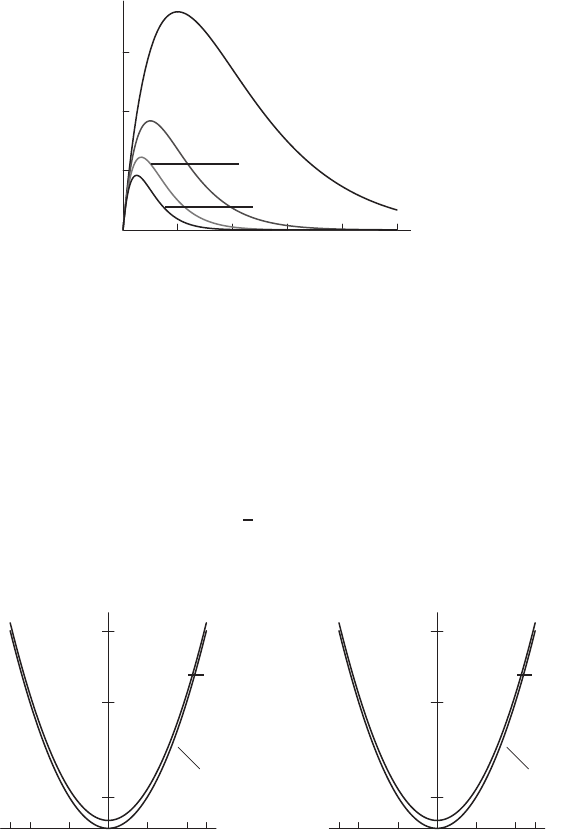
12.2 SOLUTIONS 1153
(b) Holding tfixed at 1 means that we are focusing on the blood 1 hour after the injection; letting xvary means we
are considering the effect of different doses at that instant. Thus, the function f(x, 1) gives the concentration of
the drug in the blood 1 hour after injection as a function of the amount injected. Figure 12.26 shows the graph of
f(x, 1) = e−(5−x)=ex−5. Notice that f(x, 1) is an increasing function of x. This makes sense: If we administer
more of the drug, the concentration in the bloodstream is higher.
18. The one-variable function f(a, t)represents the effect of an injection of amg at time t. Figure 12.27 shows the graphs of
the four functions f(1, t) = te−4t,f(2, t) = te−3t,f(3, t) = te−2t, and f(4, t) = te−tcorresponding to injections of
1, 2, 3, and 4 mg of the drug. The general shape of the graph is the same in every case: The concentration in the blood is
zero at the time of injection t= 0, then increases to a maximum value, and then decreases toward zero again. We see that
if a larger dose of the drug is administered, the peak of the graph is later and higher. This makes sense, since a larger dose
will take longer to diffuse fully into the bloodstream and will produce a higher concentration when it does.
12345
0.1
0.2
0.3
✛a= 1
✛a= 2
a= 3
a= 4
t
(hours)
C
(mg per liter)
Figure 12.27
: Concentration C=f(a, t)of the drug resulting from an amg injection
19. (a) is (IV), (b) is (IX), (c) is (VII), (d) is (I), (e) is (VIII), (f) is (II), (g) is (VI), (h) is (III), (i) is (V).
20. (a) This is a bowl; zincreases as the distance from the origin increases, from a minimum of 0at x=y= 0.
(b) Neither. This is an upside-down bowl. This function decreases from 1, at x=y= 0, to arbitrarily large negative
values as xand yincrease due to the negative squared terms of xand y. It looks like the bowl in part (a) except
flipped over and raised up slightly.
(c) This is a plate. Solving the equation for zgives z= 1 −x−ywhich describes a plane whose xand yslopes are −1.
It is perfectly flat, but not horizontal.
(d) Within its domain, this function is a bowl. It is undefined at points at which x2+y2>5, but within those limits it
describes the bottom half of a sphere of radius √5centered at the origin.
(e) This function is a plate. It is perfectly flat and horizontal.
21. (a)
0−2 2−4 4
4
16
25
✛x= 1
■
x= 0
y
z
(i)
Figure 12.30
: Cross-sections of
z=x2+y2
0−2 2−4 4
4
16
25
✛y= 1
■
y= 0
x
z
(ii)
Figure 12.31
: Cross-sections of
z=x2+y2
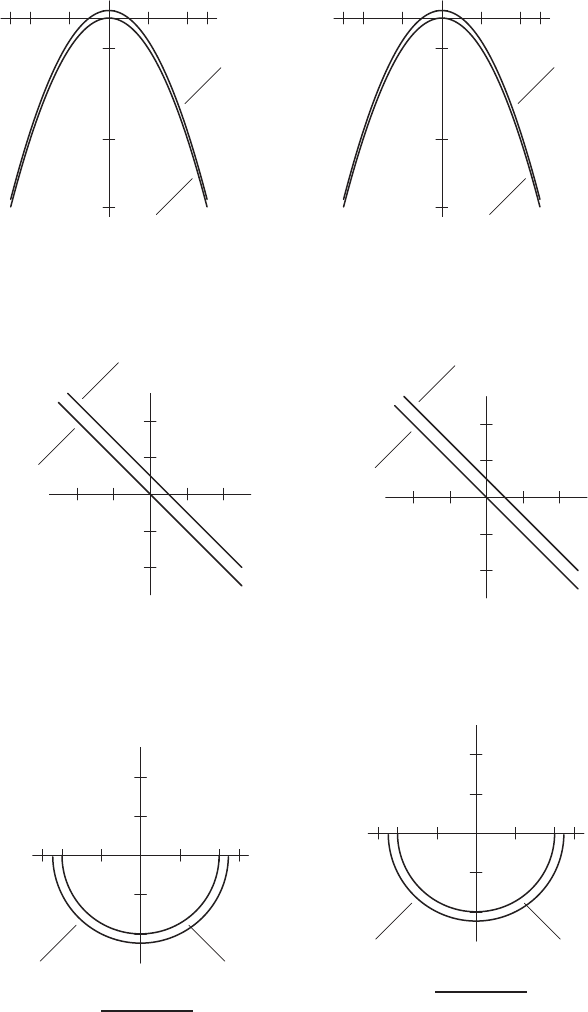
1154 Chapter Twelve /SOLUTIONS
(b)
2 4
5
1
−4
−16
−25 ✒
x= 1
✠
x= 0
y
z
(i)
Figure 12.34
: Cross-sections of
z= 1 −x2−y2
2
4 5
1
−4
−16
−25 ✒
y= 1
✠
y= 0
x
z
(ii)
Figure 12.35
: Cross-sections of
z= 1 −x2−y2
(c)
−4 4
4
−4
y
z
✠
x= 0
✒
x= 1
(i)
Figure 12.38
: Cross-sections of
x+y+z= 1
−4 4
4
−4
x
z
✠
y= 0
✒
y= 1
(ii)
Figure 12.39
: Cross-sections of x+y+z= 1
(d)
−2.5
2.5
−2
2
✒
x= 0
■
x= 1
y
z
(i)
Figure 12.42
: Cross-sections of
z=−p5−x2−y2
−2.5
2.5
−2
2
✒
y= 0
■
y= 1
x
z
(ii)
Figure 12.43
: Cross-sections of
z=−p5−x2−y2

12.2 SOLUTIONS 1155
(e)
4−4
−3
3
y
z
❘
x= 0
✠
x= 1
(i)
Figure 12.46
: Cross-section of z= 3
4−4
−3
3
x
z
❘
y= 0
✠
y= 1
(ii)
Figure 12.47
: Cross-section of z= 3
22. (a) If we have iron stomachs and can consume cola and pizza endlessly without ill effects, then we expect our happiness
to increase without bound as we get more cola and pizza. Graph (IV) shows this since it increases along both the
pizza and cola axes throughout.
(b) If we get sick upon eating too many pizzas or drinking too much cola, then we expect our happiness to decrease once
either or both of those quantities grows past some optimum value. This is depicted in graph (I) which increases along
both axes until a peak is reached, and then decreases along both axes.
(c) If we do get sick after too much cola, but are always able to eat more pizza, then we expect our happiness to decrease
after we drink some optimum amount of cola, but continue to increase as we get more pizza. This is shown by graph
(III) which increases continuously along the pizza axis but, after reaching a maximum, begins to decrease along the
cola axis.
23. One possible equation: z=x2+y2+ 5. See Figure 12.48.
y
x
z
5
Figure 12.48
24. One possible equation: x+y+z= 1. See Figure 12.49.
y
x
z
Figure 12.49

1156 Chapter Twelve /SOLUTIONS
25. One possible equation: z= (x−y)2. See Figure 12.50.
z
y
x
Figure 12.50
26. One possible equation: z=−px2+y2. See Figure 12.51.
y
x
z
Figure 12.51
27. When his fixed, say h= 1, then
V=f(r, 1) = πr21 = πr2
Similarly,
f(r, 2
3) = 4
9πr2and f(r, 1
3) = π
9r2
When ris fixed, say r= 1, then
f(1, h) = π(1)2h=πh
Similarly,
f(2, h) = 4πand f(3, h) = 9πh.
12345
0
5
10
15
20
25
r
Volume
h=1
3
f(r, 1
3)
h=2
3
f(r, 2
3)
f(r, 1)
h= 1
Figure 12.52
123450
10
20
30
40
50
r= 1
f(1, h)
r= 2
f(2, h)
r= 3
f(3, h)
h
Volume
Figure 12.53
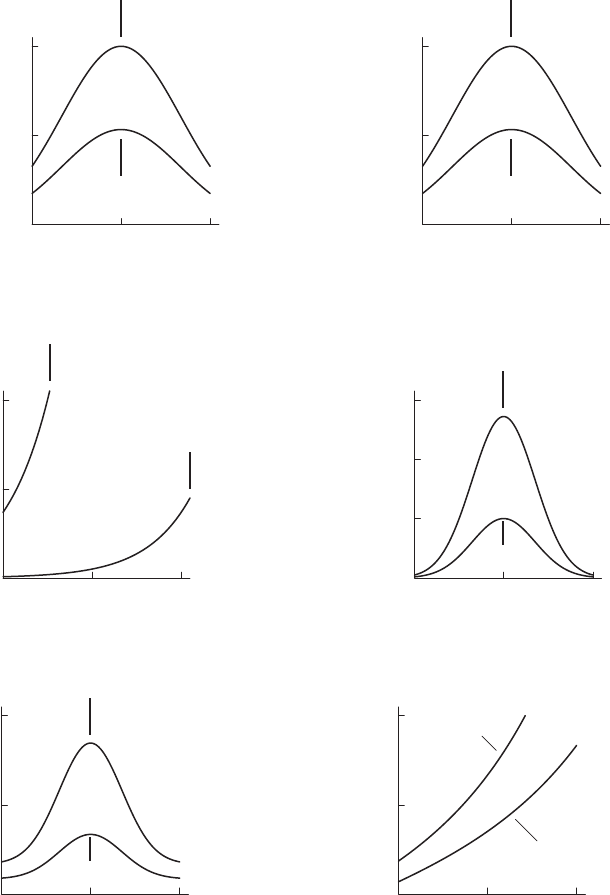
12.2 SOLUTIONS 1157
28. (a) The plane y= 0 intersects the graph in the curve z= 4x2+ 1, which is a parabola opening upward.
(b) The plane x= 0 intersects the graph in z=−y2+ 1, which is a parabola opening downward because of the negative
coefficient of y2.
(c) The plane z= 1 intersects the graph in 4x2−y2= 0. Since this factors as (2x−y)(2x+y) = 0, it is the equation
for the two lines y= 2xand y=−2x.
29.
4 8
0
0.5
1
❄
pizza fixed at
4
✻
pizza fixed at
1
(or pizza fixed at
7
)
cola
happiness
(a)
Figure 12.54
: Cross-sections of graph I
4 8
0
0.5
1
❄
cola fixed at
4
✻
cola fixed at
1
(or cola fixed at
7
)
pizza
happiness
(b)
Figure 12.55
: Cross-sections of graph I
2 4
0
0.5
1
cola
happiness
0.5
❄
pizza fixed at
2
❄
pizza fixed at
4
(or pizza fixed at
0
)
(a)
Figure 12.56
: Cross-sections of graph II
2 4
0
1
2
3
pizza
happiness
✻
cola fixed at
1
❄
cola fixed at
2
(b)
Figure 12.57
: Cross-sections of graph II
2 4
0
2
4
cola
happiness
✻
pizza fixed at
1
❄
pizza fixed at
2
(a)
Figure 12.58
: Cross-sections of graph III
1 2
0
1
2
pizza
happiness
❘
cola
fixed at
2
■
cola fixed at
1
(or cola fixed at
3
)
(b)
Figure 12.59
: Cross-sections of graph III

1158 Chapter Twelve /SOLUTIONS
1 2
0
2
4
cola
happiness
❘
pizza
fixed at
2
■
pizza fixed at
1
(a)
Figure 12.60
: Cross-sections of graph IV
1 2
0
2
4
pizza
happiness
❘
cola
fixed at
2
■
cola fixed at
1
(b)
Figure 12.61
: Cross-sections of graph IV
30. (a) Figures 12.62-12.65 show the wave profile at time t=−1,0,1,2.
x
z
t=−1
Figure 12.62
x
z
t= 0
Figure 12.63
t= 1
x
z
Figure 12.64
t= 2
z
x
Figure 12.65
(b) Increasing x
(c) The graph in Figure 12.66 represents a wave traveling in the opposite direction.
x
t
z
Figure 12.66
31. (a) Cross-sections with tfixed are in Figure 12.67. The equations are
f(x, 0) = cos 0 sin x= sin x,
f(x, π/4) = cos(π/4) sin x=1
√2sin x.
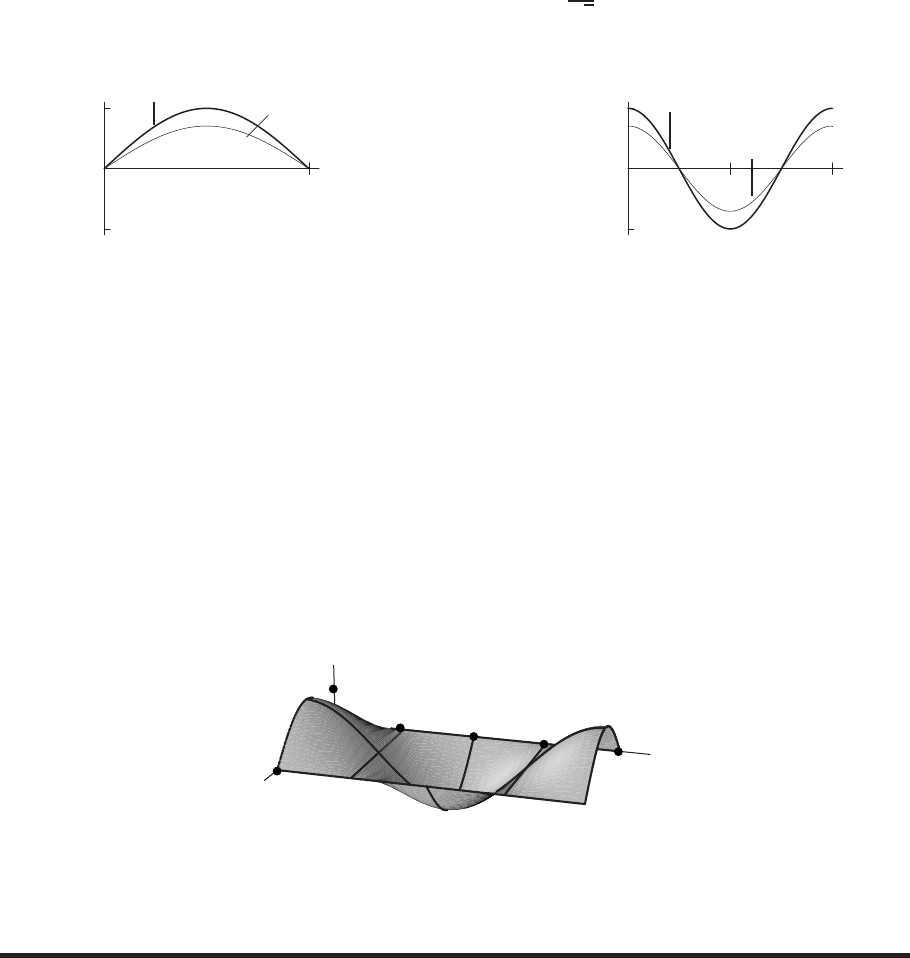
12.2 SOLUTIONS 1159
Cross-sections with tfixed are in Figure 12.68. The equations are
f(π/4, t) = cos tsin(π/4) = 1
√2cos t,
f(π/2, t) = cos tsin(π/2) = cos t.
π
−1
1❄
t= 0
✠
t=π/4
x
Figure 12.67
: Cross-sections with t
fixed
π2π
−1
1
❄
x=π/2
❄
x=π/4
t
Figure 12.68
: Cross-sections with x
fixed
(b) If x= 0, π, then f(0, t) = cos t·sin 0 = 0 = f(π, t).The ends of the string are at x= 0, π, which do not move so
the displacement is 0 there for all t.
(c) The cross-sections with tfixed are snapshots of the string at different instants in time. Graphs of these cross-sections
are the curves obtained when the the graph of fin Figure 12.69 is sliced perpendicular to the taxis. Every plane
perpendicular to the t-axis intersects the surface in one arch of a sine curve. The amplitude of the arch changes with
tas a cosine curve.
The cross-sections with xfixed show how a single point on the string moves as time goes by. Graphs of these
cross-sections are obtained by slicing the graph perpendicular to the xaxis. Notice in Figure 12.69 that the cross-
sections with x= 0 and x=πare flat lines since the endpoints of the string don’t move. The cross-section with
x=π/2is a cosine curve with amplitude 1, because the midpoint of the string oscillates back and forth. Cross-
sections with xfixed between 0 and π/2and between π/2and πare cosine curves with amplitude between 0 and 1,
representing the fact that these points on the string oscillate back and forth with the same period as x=π/2, but a
smaller amplitude.
x
t
f(x, t)
π
1
π/2π3π/22π
Figure 12.69
: Graph of vibrating string function
f(x, t) = cos tsin x
Strengthen Your Understanding
32. The graph of a function f(x, y)is a parabolic surface in 3-space, not a circle.
33. If we hold xfixed, then z=f(x, y) = x2is also fixed, so the cross-section is a line parallel to the y-axis.
34. We know that z=x2+y2+ 2 is positive everywhere and that the surface intersects the plane z= 2 only at (0,0,2). So
let f(x, y) = x2+y2+ 2.
35. The function f(x, y) = x2−1intersects the xz-plane (and any plane parallel to the xz-plane) in the parabola z=x2−1.
It also intersect the yz-plane in the line z=−1. So fis a possible example. The function g(x, y) = x2+yintersects the
xz-plane in the parabola z=x2and the yz-plane in the line y=z. So gis another possible example. There are many
others.
36. The function f(x, y) = 1 −x2−y2intersects the xy-plane in the circle x2+y2= 1. So fis a possible example. There
are many others.
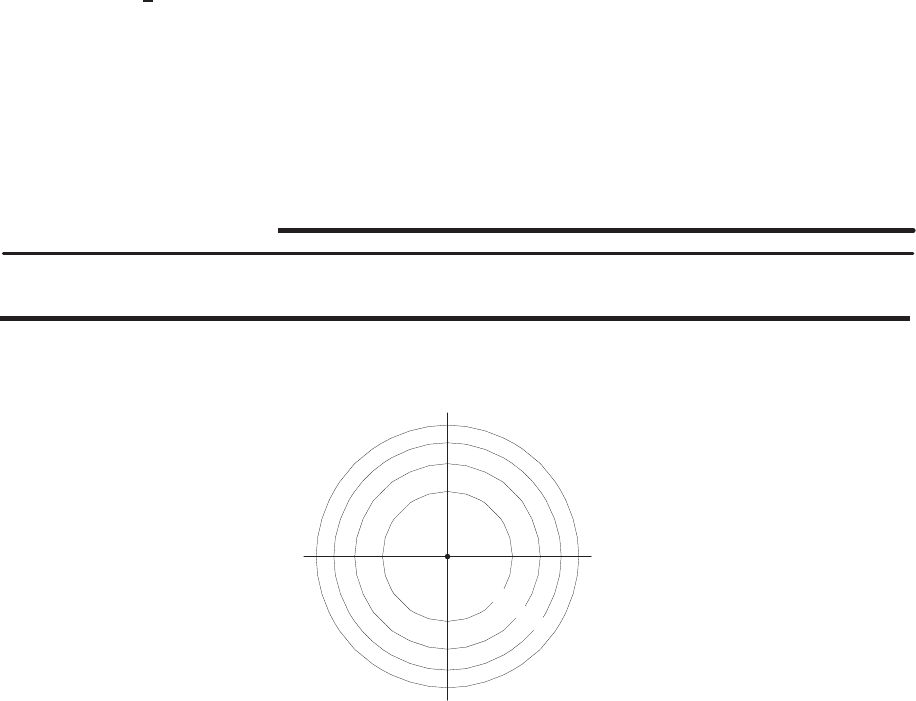
1160 Chapter Twelve /SOLUTIONS
37. False. Fixing w=kgives the one-variable function g(v) = ev/k, which is an increasing exponential function if k > 0,
but is decreasing if k < 0.
38. True. For example, consider the weekly beef consumption Cof a household as a function of total income Iand the cost of
beef per pound p. It is possible that consumption increases as income increases (for fixed p) and consumption decreases
as the price of beef increases (for fixed I).
39. True. For example, consider f(x, y) = ex·(6 −y). Then g(x) = f(x, 5) = ex, which is an increasing function of x. On
the other hand, h(x) = f(x, 10) = −4ex, which is a decreasing function of x.
40. False. The point (0,0,0) does not satisfy the equation.
41. True. The x-axis is where y=z= 0.
42. False. If x= 10, substituting gives 102+y2+z2= 10, so y2+z2=−90. Since y2+z2cannot be negative, a point
with x= 10 cannot satisfy the equation.
43. True. The cross-section with y= 1 is the line z=x+ 1.
44. True. The cross-sections with x=care all of the form z= 1 −y2.
45. True. The cross-sections with y=care of the form z= 1 −c2, which are horizontal lines.
46. True. For any aand b, we have f(a, b)6=g(a, b). The graph of gis same as the graph of f, except it is shifted 2 units
vertically.
47. True. The intersection, where f(x, y) = g(x, y), is given by x2+y2= 1 −x2−y2, or x2+y2= 1/2. This is a circle
of radius 1/√2parallel to the xy-plane at height z= 1/2.
48. False. For example, f(x, y) = x2(or any cylinder along the y-axis) is not a plane but has lines for x=ccross-sections.
49. False. Wherever f(x, y) = 0 the graphs of f(x, y)and −f(x, y)will intersect.
50. True. The graph is the bowl-shaped g(x, y) = x2+y2turned upside-down and shifted upward by 10 units.
51. (c), a plane. While xis fixed at 2, yand zcan vary freely.
Solutions for Section 12.3
Exercises
1. We’ll set z= 4 at the peak. See Figure 12.70.
x
y
4
3
2
1
Figure 12.70

12.3 SOLUTIONS 1161
2. See Figure 12.71.
y
x
1 6 1
Figure 12.71
3. We will take z= 4 to be the flat area. See Figure 12.72.
x
y
z= 1
z= 2
z= 3
Figure 12.72
4. See Figure 12.73.
y
x
−3
−2
−1
−3
−2
−1
1 2 3123
Figure 12.73
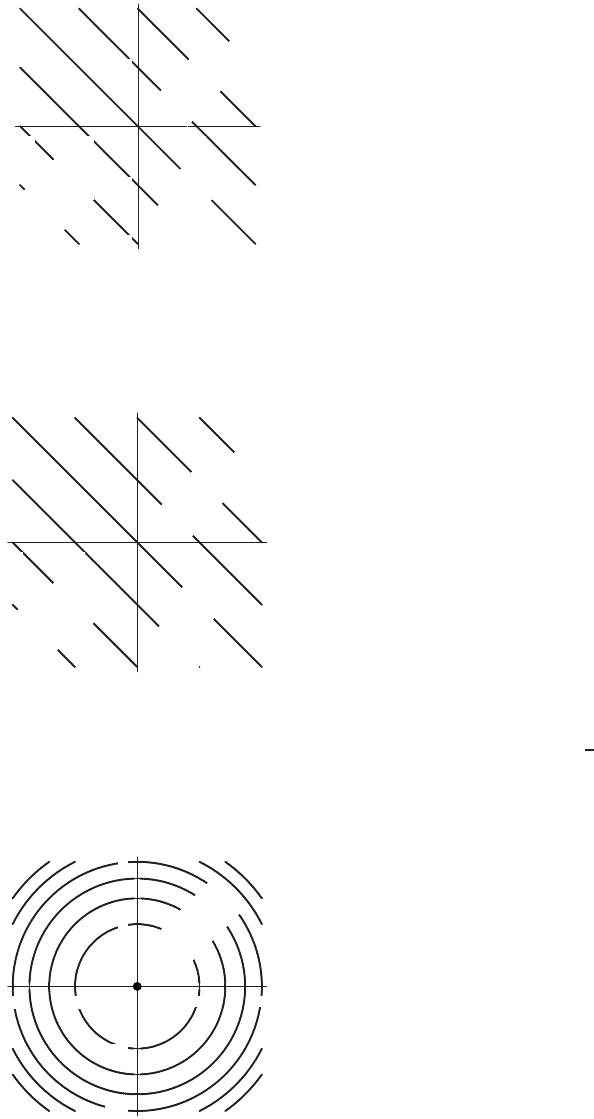
1162 Chapter Twelve /SOLUTIONS
5. The contour where f(x, y) = x+y=c, or y=−x+c, is the graph of the straight line with slope −1as shown in
Figure 12.74. Note that we have plotted the contours for c=−3,−2,−1,0,1,2,3. The contours are evenly spaced.
x
y
−2−1 1 2
−2
−1
1
2
c= 0
c=−1
c=−2
c=−3
c= 1
c= 2
c= 3
Figure 12.74
6. The contour where f(x, y) = 3x+ 3y=cor y=−x+c/3is the graph of the straight line of slope −1as shown in
Figure 12.75. Note that we have plotted the contours for c=−9,−6,−3,0,3,6,9. The contours are evenly spaced.
x
y
−2−1 1 2
−2
−1
1
2
c= 0
c=−3
c=−6
c=−9
c= 3
c= 6
c= 9
Figure 12.75
7. The contour where f(x, y) = x2+y2=c, where c≥0, is the graph of the circle centered at (0,0), with radius √c
as shown in Figure 12.76. Note that we have plotted the contours for c= 0,1,2,3,4. The contours become more closely
packed as we move further from the origin.
x
y
c= 1
c= 2
c= 3
c= 4
c= 0
−2−1 1 2
−2
−1
1
2
Figure 12.76
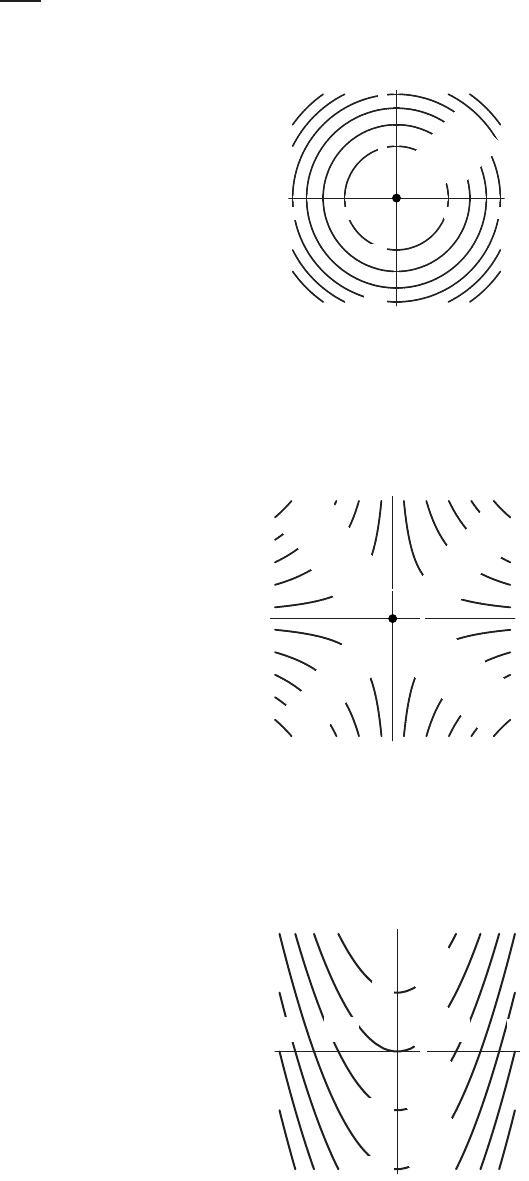
12.3 SOLUTIONS 1163
8. The contour where f(x, y) = −x2−y2+ 1 = c, where c≤1, is the graph of the circle centered at (0,0), with radius
√1−cas shown in Figure 12.77. Note that we have plotted the contours for c=−3,−2,−1,0,1. The contours become
more closely packed as we move further from the origin.
x
y
c= 0
c=−3
c=−1
c=−2
−2−1 1 2
−2
−1
1
2
c= 1
Figure 12.77
9. The contour where f(x, y) = xy =c, is the graph of the hyperbola y=c/x if c6= 0 and the coordinate axes if c= 0,
as shown in Figure 12.78. Note that we have plotted contours for c=−5,−4,−3,−2,−1,0,1,2,3,4,5. The contours
become more closely packed as we move further from the origin.
x
y
c=−1
c=−2
c=−3
c=−4
c=−1
c=−2
c=−3
c=−4
c= 1
c= 2
c= 3
c= 4
c= 1
c= 2
c= 3
c= 4
c= 0
Figure 12.78
10. The contour where f(x, y) = y−x2=cis the graph of the parabola y=x2+c, with vertex (0, c)and symmetric about
the y-axis, shown in Figure 12.79. Note that we have plotted the contours for c=−2,−1,0,1. The contours become
more closely packed as we move farther from the y-axis.
−2−11 2
−2
−1
1
2
x
y
c= 1
c= 0
c=−1
c=−2
Figure 12.79
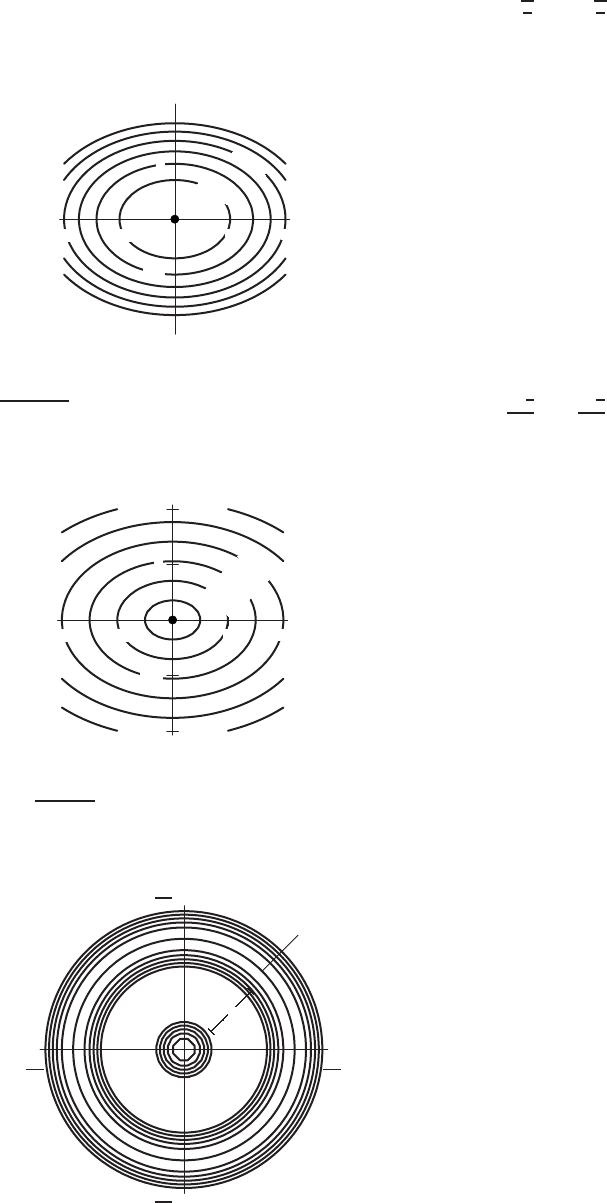
1164 Chapter Twelve /SOLUTIONS
11. The contour where f(x, y) = x2+ 2y2=c, where c≥0, is the graph of the ellipse with focuses (−pc
2,0),(pc
2,0)
and axes lying on x- and y-axes as shown in Figure 12.80. Note that we have plotted the contours for c= 0,1,2,3,4.
The contours become more closely packed as we move further from the origin.
−2−1 1 2
−2
−1
1
2
x
y
c= 1
c= 4
c= 0
Figure 12.80
12. The contour where f(x, y) = px2+ 2y2=c, where c≥0, is the graph of the ellipse with focuses (−c√2
2,0),(c√2
2,0)
and axes lying on x- and y-axes as shown in Figure 12.81. Note that we have plotted the contours for c= 0,1,2,3,4. See
Figure 12.81.
42
4
2
−4−2
−4
−2
x
y
c= 2
c= 3
c= 4
Figure 12.81
13. The contour where f(x, y) = cos(px2+y2) = c, where −1≤c≤1, is a set of circles centered at (0,0), with radius
cos−1c+ 2kπ with k= 0,1,2, .. and −cos−1c+ 2kπ, with k= 1,2,3, ... as shown in Figure 12.82. Note that we have
plotted contours for c= 0,0.2,0.4,0.6,0.8,1.
5π
2
−5π
2
5π
2
−5π
2
x
y
✠
c= 1
✛
✛
c= 0
Figure 12.82
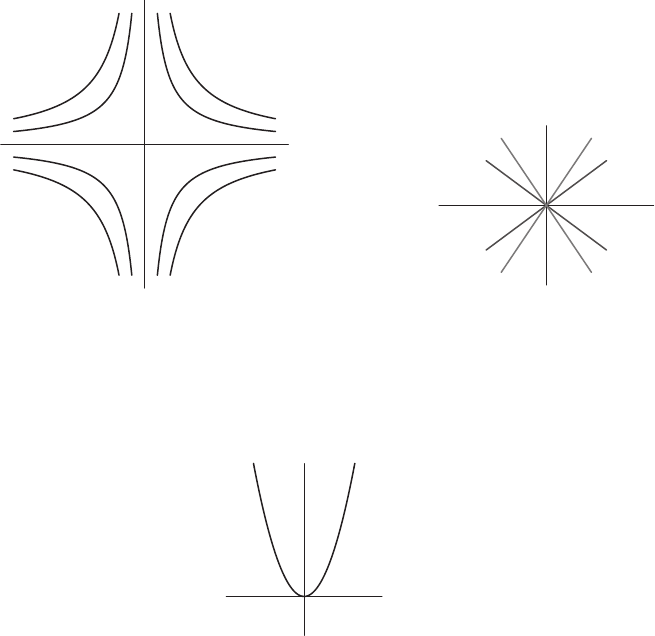
12.3 SOLUTIONS 1165
14. Since f(5,10) = 3 ·52·10 + 7 ·5 + 20 = 805, an equation for the contour is
3x2y+ 7x+ 20 = 805.
15. (a) Level curves are in Figure 12.83.
z= 1
z= 2
z=−1
z=−2
x
y
z=−1
z=−2
z= 1
z= 2
Figure 12.83
y
z
z=−2y(x=−2)
z= 2y(x= 2)
z=y(x= 1)
z=−y(x=−1)
Figure 12.84
(b) Cross-sections with xconstant are in Figure 12.84
(c) Setting y=xgives the curve z=x2in Figure 12.85
Line
x=y
z
Curve
z=x2
Figure 12.85
16. (a) (III)
(b) (I)
(c) (V)
(d) (II)
(e) (IV)
17. The values in Table 12.5 are not constant along rows or columns and therefore cannot be the lines shown in (I) or (IV).
Also observe that as you move away from the origin, whose contour value is 0, the z-values on the contours increase.
Thus, this table corresponds to diagram (II).
The values in Table 12.6 are also not constant along rows or columns. Since the contour values are decreasing as you
move away from the origin, this table corresponds to diagram (III).
Table 12.7 shows that for each fixed value of x, we have constant contour value, suggesting a straight vertical line at
each x-value, as in diagram (IV).
Table 12.8 also shows lines, however these are horizontal since for each fixed value of ywe have constant contour
values. Thus, this table matches diagram (I).
18. Superimposing the surface z= 1/2on the graph of f(x, y)gives Figure 12.86. The contour f(x, y) = 1/2is the
intersection of the two surfaces; that is, the collection of closed curves as shown in Figure 12.87
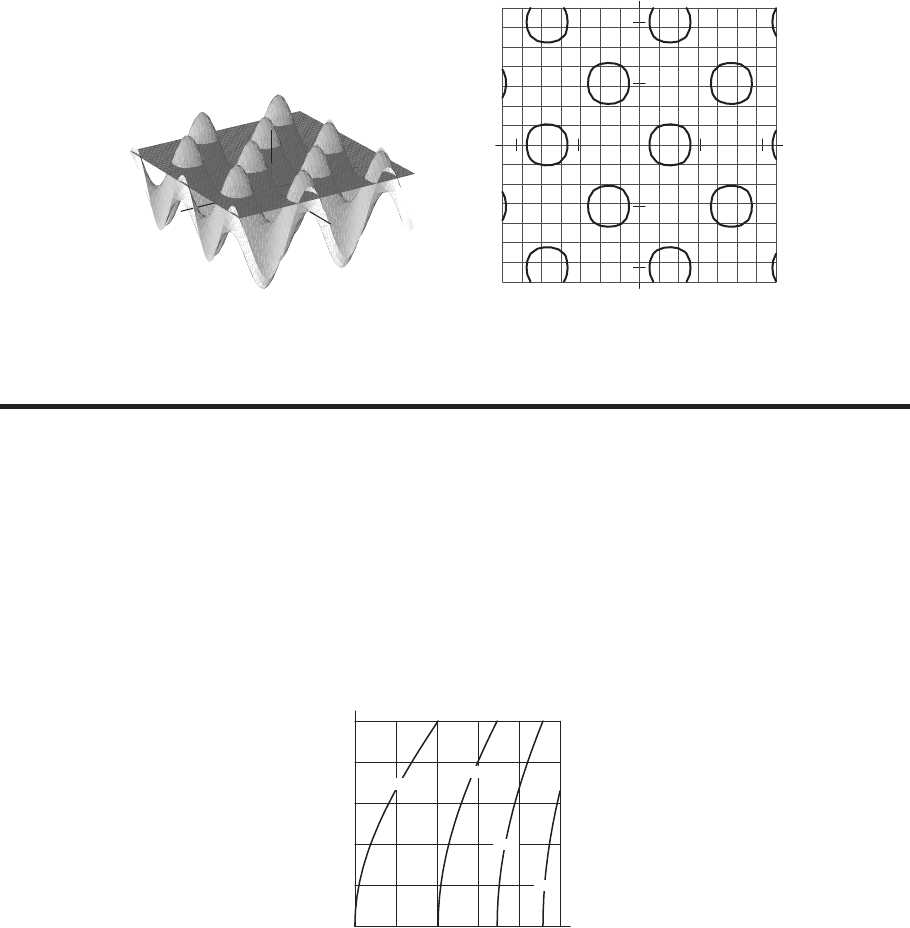
1166 Chapter Twelve /SOLUTIONS
xy
z
Figure 12.86
−2π−ππ2π
−2π
−π
π
2π
x
y
Figure 12.87
Problems
19. We expect total sales to decrease as the price increases and to increase as advertising expenditures increase. Moving
parallel to the x-axis, the Q-values on the contours decrease, whereas moving parallel to the y-axis, the Q-values increase.
Thus, xis the price and yis advertising expenditures
20. To find a value, evaluate f(x, y) = 100ex−50y2at any point (x, y)on the contour. Check by evaluating the function at
a couple of points on each contour. Starting from the left and estimating points on the contour, we have
First contour: f(0,0) = 100,f(0.2,0.65) = 101
Second contour: f(0.4,0) = 149,f(0.6,0.8) = 150
Third contour: f(0.7,0) = 201,f(0.8,0.65) = 201
Fourth contour: f(0.92,0) = 251,f(1,0.65) = 251.
Since the true values of fare equally spaced multiples of 10, it seems that they must be 100, 150, 200, and 250. See
Figure 12.88.
0.2 0.4 0.6 0.8 1
0.2
0.4
0.6
0.8
1
200
100 150
250
x
y
Figure 12.88
21. (a) We have
f(x, y) = x2−y2−2x+ 4y−3 = (x−1)2−(y−2)2.
Thus, the graph of fhas the same saddle shape as that of z=x2−y2but centered at x= 1,y= 2. The function
increases in the x-direction and decreases in the y-direction, so fcorresponds to III.
(b) We have
g(x, y) = x2+y2−2x−4y+ 15 = (x−1)2+ (y−2)2+ 10.
Thus, the graph of gis a paraboloid opening upward, with vertex at (1,2,10). So hcorresponds to VI.
(c) We have
h(x, y) = −x2−y2+ 2x+ 4y−8 = −(x−1)2−(y−2)2−3.
Thus, the graph of his a paraboloid opening downward, with vertex at (1,2,−3). So hcorresponds to I.
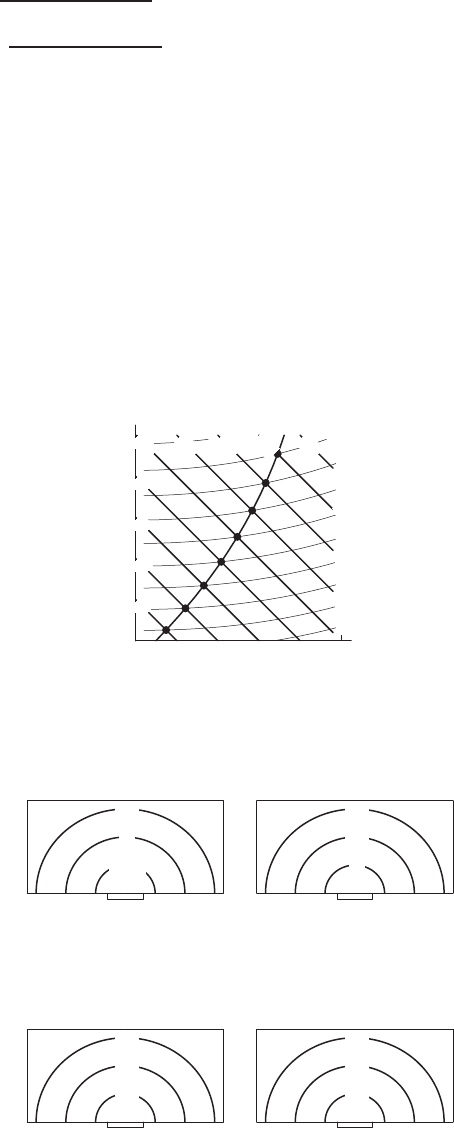
12.3 SOLUTIONS 1167
(d) We have
j(x, y) = −x2+y2+ 2x−4y+ 3 = −(x−1)2+ (y−2)2.
Thus, the graph of jhas the same saddle shape as that of z=−x2+y2but centered at x= 1,y= 2. The function
decreases in the x-direction and increases in the y-direction, so jcorresponds to IV.
(e) Since k(x, y) = p(x−1)2+ (y−2)2, the graph of kis a cone opening upward with vertex at (1,2,0). Thus, the
graph of kcorresponds to II.
(f) Since l(x, y) = −p(x−1)2+ (y−2)2, the graph of lis a cone opening downward with vertex at (1,2,0). Thus,
the graph of lcorresponds to V.
22. (a) Find the point where the horizontal line for 15 mph meets the contour for −20◦F wind chill. The actual temperature
is about 0◦F.
(b) The horizontal line for 10 mph meets the vertical line for 0◦F about 1/5of the way from the contour for −20◦F to
the contour for 0◦F wind chill. We estimate the wind chill to be about −16◦F.
(c) We look for the point on the vertical line for −20◦F where the wind chill is −50◦F, the danger point for humans.
This is a point on the line that is about half way between the contours for −60◦F and −40◦F. The point can not be
determined exactly, but we estimate that it occurs where the wind speed is about 23 mph.
(d) A temperature drop of 20◦F corresponds to moving left from one vertical grid line to the next on the horizontal
line for 15 mph. This horizontal movement appears to correspond to about 1 1/4the horizontal distance between
contours crossing the line. Since contours are spaced at 20◦F wind chill, we estimate that the wind chill drops about
25◦F when the air temperature goes down 20◦F during a 15 mph wind.
23. To sketch the curve, first put dots on the point where an fcontour crosses a gcontour of the same value. Then connect
the dots with a smooth curve. See Figure 12.89.
10
10
2
4
6
8
10
12
14
16
18
0
2
4
6
8
10
12
14
16
x
y
Figure 12.89
: Black: f(x, y). Blue; g(x, y)
24. Many different answers are possible. Answers are in degrees Celsius.
(a) Minnesota in winter. See Figure 12.90.
−10
0
10
Figure 12.90
5
10
15
Figure 12.91
(b) San Francisco in winter. See Figure 12.91.
(c) Houston in summer. See Figure 12.92.
55
40
30
Figure 12.92
26
24
22
Figure 12.93
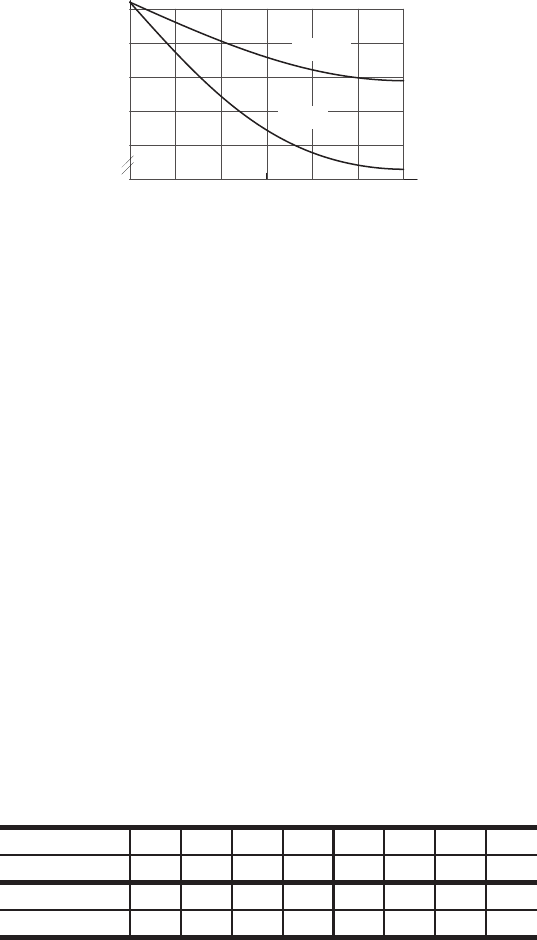
1168 Chapter Twelve /SOLUTIONS
(d) Oregon in summer. See Figure 12.93.
25. The point x= 10,t= 5 is between the contours H= 70 and H= 75, a little closer to the former. Therefore, we
estimate H(10,5) ≈72, i.e., it is about 72◦F. Five minutes later we are at the point x= 10,t= 10, which is just above
the contour H= 75, so we estimate that it has warmed up to 76◦F by then.
26. The line t= 5 crosses the contour H= 80 at about x= 4; this means that H(4,5) ≈80, and so the point (4,80) is
on the graph of the one-variable function y=H(x, 5). Each time the line crosses a contour, we can plot another point
on the graph of H(x, 5), and thus get a sketch of the graph. See Figure 12.94. Each data point obtained from the contour
map has been indicated by a dot on the graph. The graph of H(x, 20) was obtained in a similar way.
5 10 15 20 25 30
0
65
70
75
80
85
x
H
t= 20
t= 5
Figure 12.94
: Graph of H(x, 5) and H(x, 20): heat as a function of distance from the
heater at t= 5 and t= 20 minutes
These two graphs describe the temperature at different positions as a function of xfor t= 5 and t= 20.
Notice that the graph of H(x, 5) descends more steeply than the graph of H(x, 20); this is because the contours are
quite close together along the line t= 5, whereas they are more spread out along the line t= 20. In practical terms the
shape of the graph of H(x, 5) tells us that the temperature drops quickly as you move away from the heater, which makes
sense, since the heater was turned on just five minutes ago. On the other hand, the graph of H(x, 20) descends more
slowly, which makes sense, because the heater has been on for 20 minutes and the heat has had time to diffuse throughout
the room.
27. (a) The contour lines are much closer together on path A, so path Ais steeper.
(b) If you are on path Aand turn around to look at the countryside, you find hills to your left and right, obscuring the
view. But the ground falls away on either side of path B, so you are likely to get a much better view of the countryside
from path B.
(c) There is more likely to be a stream alongside path A, because water follows the direction of steepest descent.
28. (a) The point representing 13% and $6000 on the graph lies between the 120 and 140 contours. We estimate the monthly
payment to be about $137.
(b) Since the interest rate has dropped, we will be able to borrow more money and still make a monthly payment of $137.
To find out how much we can afford to borrow, we find where the interest rate of 11% intersects the $137 contour
and read off the loan amount to which these values correspond. Since the $137 contour is not shown, we estimate its
position from the $120 and $140 contours. We find that we can borrow an amount of money that is more than $6000
but less than $6500. So we can borrow about $250 more without increasing the monthly payment.
(c) The entries in the table will be the amount of loan at which each interest rate intersects the 137 contour. Using the
$137 contour from (b) we make table 12.11.
Table 12.11
Amount borrowed at a monthly payment of
$
137.
Interest Rate (%) 0 1 2 3 4 5 6 7
Loan Amount ($) 8200 8000 7800 7600 7400 7200 7000 6800
Interest rate (%) 8 9 10 11 12 13 14 15
Loan Amount ($) 6650 6500 6350 6250 6100 6000 5900 5800
(a) The point representing 8% and $6000 on the graph lies between the 120 and 140 contours. We estimate the monthly
payment to be about $122.
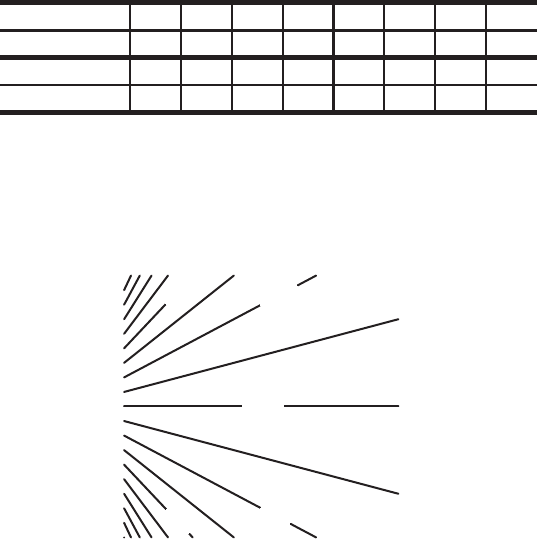
12.3 SOLUTIONS 1169
(b) Since the interest rate has dropped, we will be able to borrow more money and still make a monthly payment of $122.
To find out how much we can afford to borrow, we find where the interest rate of 6% intersects the $122 contour
and read off the loan amount to which these values correspond. Since the $122 contour is not shown, we estimate its
position from the $120 and $140 contours. We find that we can borrow an amount of money that is more than $6000
but less than $6500. So we can borrow about $350 more without increasing the monthly payment.
(c) The entries in the table will be the amount of loan at which each interest rate intersects the 122 contour. Using the
$122 contour from (b) we make table 12.12.
Table 12.12
Amount borrowed at a monthly payment of
$
122.
Interest Rate (%) 0 1 2 3 4 5 6 7
Loan Amount ($) 7400 7200 7000 6800 6650 6500 6350 6200
Interest rate (%) 8 9 10 11 12 13 14 15
Loan Amount ($) 6000 5850 5700 5600 5500 5400 5300 5200
29. The vertical spacing between the contours just north and just south of the trail increases as you move eastward along the
trail. A possible contour diagram is in Figure 12.95.
Trail
1000
1010
1020
990
980
Elevation in meters
Figure 12.95
30. (a) I
(b) IV
(c) II
(d) III
See Figure 12.96.
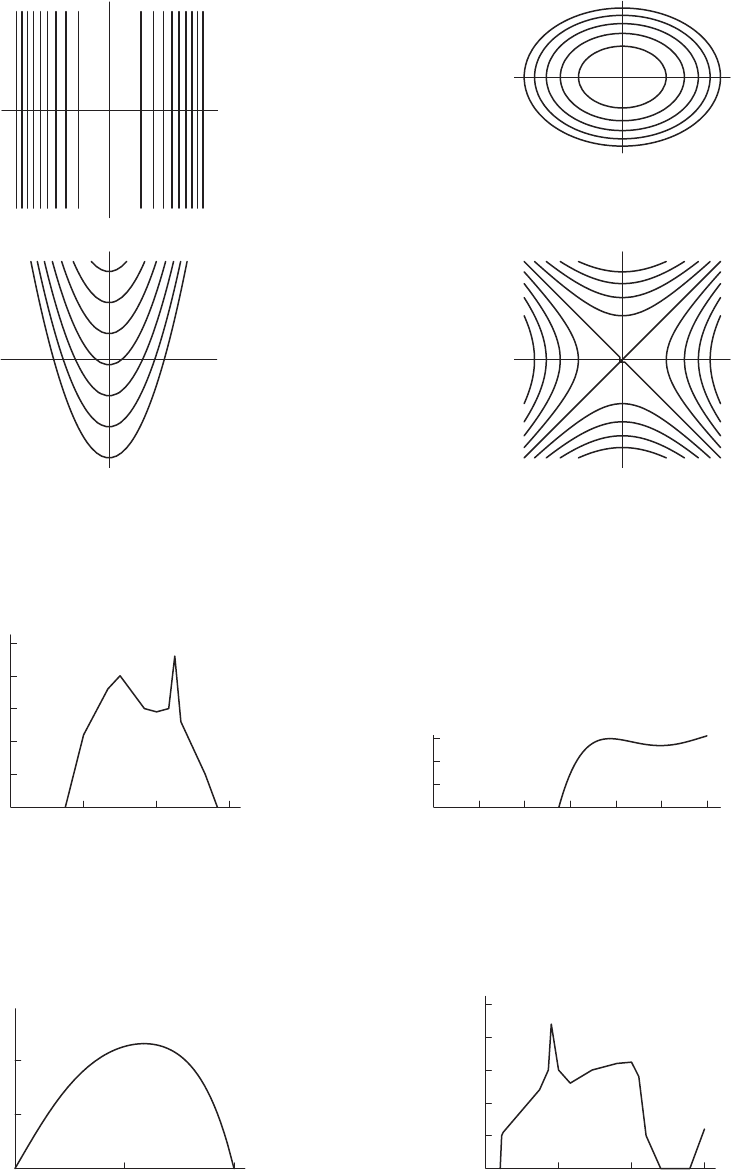
1170 Chapter Twelve /SOLUTIONS
x
y
(a)
x
y
(b)
x
y
(c)
x
y
(d)
Figure 12.96
31. Figure 12.97 shows an east-west cross-section along the line N= 50 kilometers.
Figure 12.98 shows an east-west cross-section along the line N= 100 kilometers.
60 120 180
0.5
1
1.5
2
2.5
East
Density of the
fox population
P
Figure 12.97
30 60 90 120 150 180
0.5
1
1.5
East
Density of the
fox population
P
Figure 12.98
Figure 12.99 shows a north-south cross-section along the line E= 60 kilometers.
Figure 12.100 shows a north-south cross-section along the line E= 120 kilometers.
35 70
0.5
1
North
Density of the
fox population
P
Figure 12.99
50 100 150
0.5
1
1.5
2
2.5
North
Density of the
fox population
P
Figure 12.100
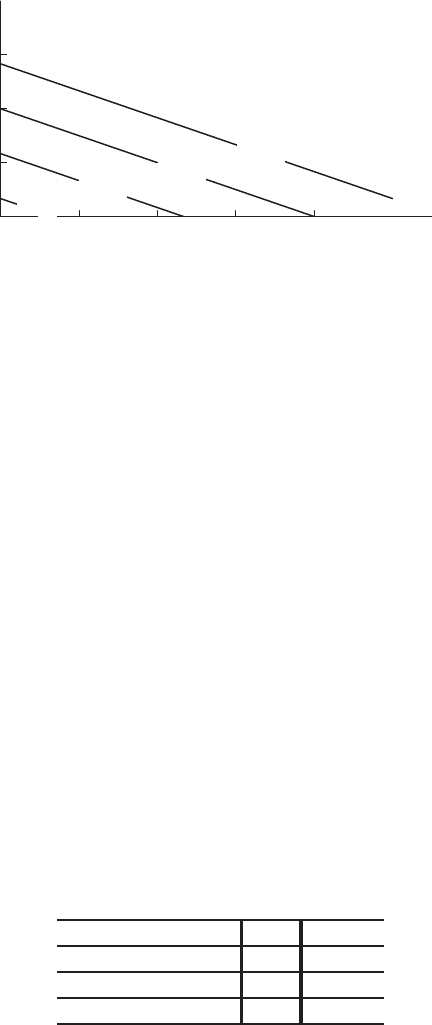
12.3 SOLUTIONS 1171
32. (a) The profit is given by the following:
π=Revenue from q1+Revenue from q2−Cost.
Measuring πin thousands, we obtain:
π= 3q1+ 12q2−4.
(b) A contour diagram of πfollows. Note that the units of πare in thousands.
2 4 6 8
1
2
3
q1
q2
π= 0
π= 10
π= 20
π= 30
33. For any Cobb-Douglass function F(K, L) = bLαKβ, if we increase the inputs by a factor of m, from (K, L)to
(mK, mL)we get:
F(mK, mL) = b(mL)α(mK)β
=mα+βbLαKβ
=mα+βF(K, L)
Thus we see that increasing inputs by a factor of mincreases outputs by a factor of mα+β.
If α+β < 1, then increasing each input by a factor of mwill result in an increase in output of less than a factor of
m. This applies to statements (a)and (E). In statement (a),α+β= 0.25 + 0.25 = 0.5, so increasing inputs by a factor
of m= 4, as in statement (E), increases output by a factor of 40.5= 2. We can match statements (a)and (E)to graph
(II)by noting that when (K, L) = (1,1), we have F= 1 and when we double the inputs (m= 2) to (K, L) = (2,2),
Fincreases by less than a factor of 2. This is called decreasing returns to scale.
If α+β= 1, then increasing Kand Lby a factor of mwill result in an increase in Fby the same factor m. This
applies to statements (b)and (D). In statement (b),α+β= 0.5 + 0.5 = 1, and in statement (D), an increase in inputs
by a factor of 3 results in an increase in Fby the same factor. We match these statements to graph (I)where we see that
increasing (K, L)from (1,1) to (3,3) results in an increase in Ffrom F= 1 to F= 3. This is called constant returns
to scale.
If α+β > 1, then we have increasing returns to scale, i.e. an increase in Kand Lby a factor of mresults in an
increase in Fby more than a factor of m. This is the case for equation (c), where α+β= 0.75 + 0.75 = 1.5. Statement
(G)also applies an increase in inputs by a factor of m= 2 results in an increase in output by more than 2, in this case
by a factor of almost 3. We can match statements (c)and (G)to graph (III), where we see that increasing (K, L)from
(1,1) to (2,2) results in a change in Fby more than a factor of 2 (but less than a factor of 3). This is called increasing
returns to scale.
This information is summarized in Table 12.13.
Table 12.13
Function Graph Statement
F(L, K) = L0.25K0.25 (II) (E)
F(L, K) = L0.5K0.5(I) (D)
F(L, K) = L0.75K0.75 (III) (G)
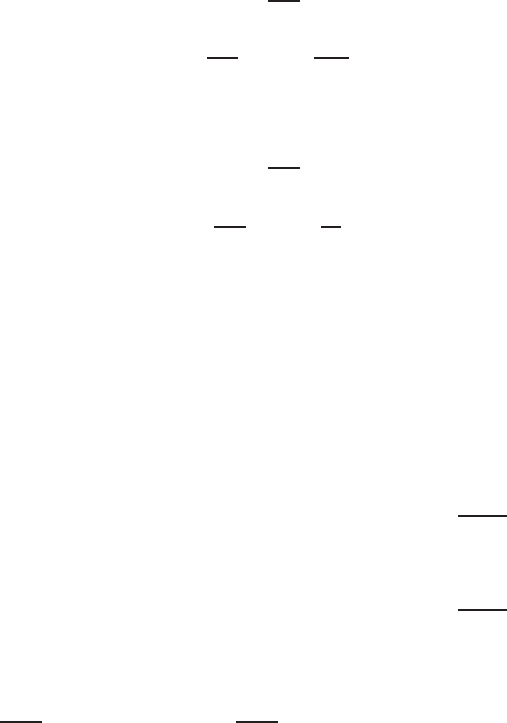
1172 Chapter Twelve /SOLUTIONS
34. Suppose P0is the production given by L0and K0, so that
P0=f(L0, K0) = cLα
0Kβ
0.
We want to know what happens to production if L0is increased to 2L0and K0is increased to 2K0:
P=f(2L0,2K0)
=c(2L0)α(2K0)β
=c2αLα
02βKβ
0
= 2α+βcLα
0Kβ
0
= 2α+βP0.
Thus, doubling Land Khas the effect of multiplying Pby 2α+β. Notice that if α+β > 1, then 2α+β>2, if α+β= 1,
then 2α+β= 2, and if α+β < 1, then 2α+β<2. Thus, α+β > 1gives increasing returns to scale, α+β= 1 gives
constant returns to scale, and α+β < 1gives decreasing returns to scale.
35. (a) If f(x, y) = x0.2y0.8=c, then solving for ygives
y0.8=c
x0.2
y=c
x0.21/0.8
=A
x1/4.
Here Ais another constant, A=c1/0.8.
Similarly, if g(x, y) = x0.8y0.2=k, then solving for ygives
y0.2=k
x0.8
y=k
x0.81/0.2
=B
x4.
Since the y-values in Figure (I) decay more quickly than those in Figure (II), we see that Figure (I) is g(x, y)and
Figure (II) is f(x, y).
(b) Since the y-values in Figure (III) decrease slower than in Figure (I) and faster than in Figure (II), we have 0.2< α <
0.8.
36. Using the rules of logarithms on fand ggives
f(x, y) = ln(x0.7y0.3)
g(x, y) = ln(x0.3y0.7).
Thus the level curves of fare of the form
ln(x0.7y0.3) = cso x0.7y0.3=ec=Aor y=A1/0.3
x7/3.
The level curves of gare of the form
ln(x0.3y0.7) = cso x0.3y0.7=ec=Aor y=A1/0.7
x3/7.
The level curves of hand jare ellipses. For any constant c, the level curve
h(x, y) = 0.3x2+ 0.7y2=c
cuts the x-axis at x=pc/0.3and the y-axis at y=pc/0.7. Thus the x-intercept is larger than the y-intercept. A
similar argument tells us that the x-intercept of j(x, y) = 0.7x2+ 0.3y2=cis smaller than its y-intercept.
Thus Graph (I) is h(x, y); Graph (II) is j(x, y); Graph (III) is f(x, y); Graph (IV) is g(x, y).
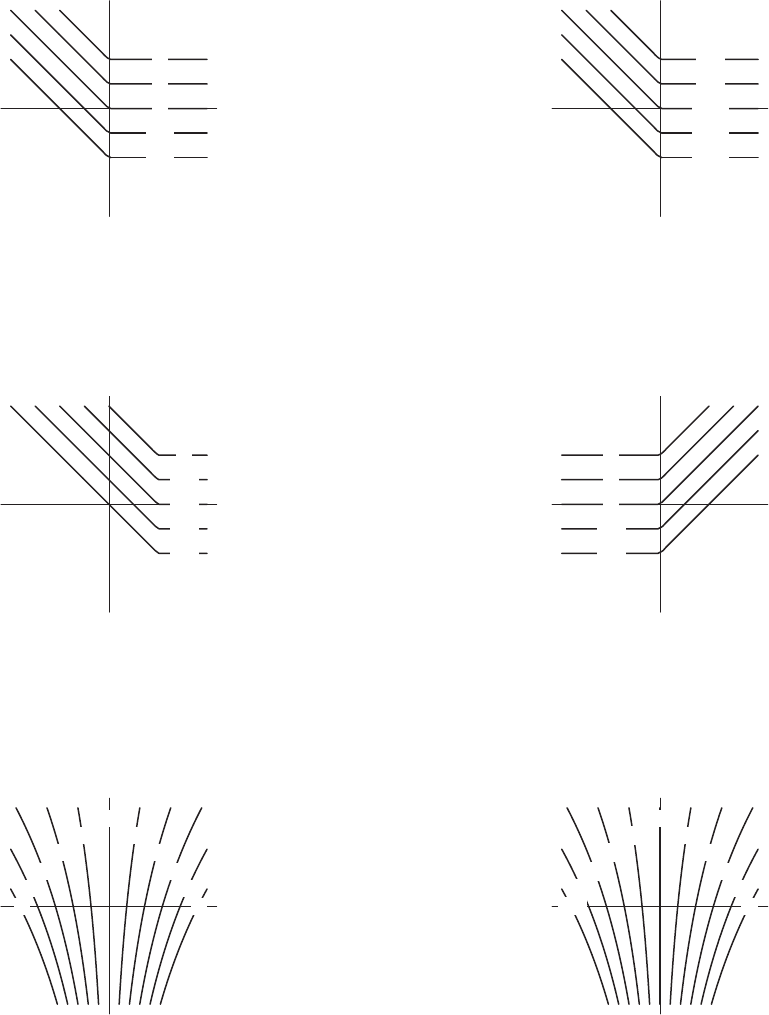
12.3 SOLUTIONS 1173
37. (a) Multiply the values on each contour of the original contour diagram by 3. See Figure 12.101.
−6
−3
0
3
6
x
y
Figure 12.101
:3f(x, y)
−12
−11
−10
−9
−8
x
y
Figure 12.102
:f(x, y)−10
(b) Subtract 10 from the values on each contour. See Figure 12.102.
(c) Shift the diagram 2 units to the right and 2 units up. See Figure 12.103.
−4
−3
−2
−1
0
x
y
Figure 12.103
:f(x−2, y −2)
−2
−1
0
1
2
x
y
Figure 12.104
:f(−x, y)
(d) Reflect the diagram about the y-axis. See Figure 12.104.
38. (a) See Figure 12.105.
0
1
2
3
4
5
1
2
3
4
5x
y
Figure 12.105
0
1
2
3
4
5
−1
−2
−3
−4
−5x
y
Figure 12.106
(b) See Figure 12.106.
39. Since f(x, y) = x2−y2= (x−y)(x+y) = 0 gives x−y= 0 or x+y= 0, the contours f(x, y) = 0 are the lines
y=xor y=−x. In the regions between them, f(x, y)>0or f(x, y)<0as shown in Figure 12.107. The surface
z=f(x, y)is above the xy-plane where f > 0(that is on the shaded regions containing the x-axis) and is below the

1174 Chapter Twelve /SOLUTIONS
xy-plane where f < 0. This means that a person could sit on the surface facing along the positive or negative x-axis, and
with his/her legs hanging down the sides below the y-axis. Thus, the graph of the function is saddle-shaped at the origin.
f > 0
f < 0
f > 0
f < 0
f= 0f= 0
y=xy=−x
x
y
Figure 12.107
40. We need three lines with g(x, y) = 0, so that the xy-plane is divided into six regions. For example
g(x, y) = y(x−y)(x+y)
has the contour map in Figure 12.108. (Many other answers to this question are possible.)
g > 0
g < 0
g > 0
g < 0
g > 0
g < 0
g= 0
y=x
g= 0 g= 0
y=−x
x
y
Figure 12.108
41. To read off the cross-sections of fwith tfixed, we choose a tvalue and move horizontally across the diagram looking at
the values on the contours. For t= 0, as we move from the left at x= 0 to the right at x=π, we cross contours of 0.25,
0.50,0.75 and reach a maximum at x=π/2, and then decrease back to 0. That is because if time is fixed at t= 0, then
f(x, 0) is the displacement of the string at that time: no displacement at x= 0 and x=πand greatest displacement at
x=π/2. For cross-sections with tfixed at larger values, as we move along a horizontal line, we cross fewer contours
and reach a smaller maximum value: the string is becoming less curved. At time t=π/2, the string is straight so we see
a value of 0all the way across the diagram, namely a contour with value 0. For t=π, the string has vibrated to the other
side and the displacements are negative as we read across the diagram reaching a minimum at x=π/2.
The cross-sections of fwith xfixed are read vertically. At x= 0 and x=π, we see vertical contours of value 0
because the end points of the string have 0displacement no matter what time it is. The cross-section for x=π/2is found
by moving vertically up the diagram at x=π/2. As we expect, the contour values are largest at t= 0, zero at t=π/2,
and a minimum at t=π.
Notice that the spacing of the contours is also important. For example, for the t= 0 cross-section, contours are most
closely spaced at the end points at x= 0 and x=πand most spread out at x=π/2. That is because the shape of the
string at time t= 0 is a sine curve, which is steepest at the end points and relatively flat in the middle. Thus, the contour
diagram shows the steepest terrain at the end points and flattest terrain in the middle.
42. (a) Since Pis proportional to d2and to v3, a formula for Pis P(d, v) = kd2v3, where kis the constant of proportion-
ality.

12.3 SOLUTIONS 1175
(b) Let dbe the diameter of the original windmill, and let v1be the wind speed at which the windmill produces 100 kW.
Then
kd2v3
1= 100,and thus k=100
d2v3
1
.
The second windmill has diameter 2dand we want to find a speed v2such that k(2d)2v3
2= 100. We solve for v2:
v3
2=100
k(2d)2=100
100/(d2v3
1)·4d2=d2v3
1
4d2=v3
1
4
v2=v1
3
√4
So v2needs to be 1/3
√4of v1, or about 63% of v1.
(c) Contours of Pare curves of the form kd2v3=c, or v=3
pc/(kd2). Thus, a contour diagram for Plooks like the
diagram in Figure 12.109.
50
40
1000
100,000
10,000,000
x
y
Figure 12.109
Strengthen Your Understanding
43. A contour diagram for z=f(x, y)is a collection of curves in the xy-plane. The contour diagram is like a 2-dimensional
map of the graph of f(x, y), which is a surface in 3-space.
44. The contours of both functions are concentric circles centered at (x, y) = (0,0). However, for the equally spaced z-
values, such as z= 1,2,3,4..., the contour diagram of fconsists of equally spaced concentric circles, whereas the
contour diagram of gconsists of circles that get closer and closer together as zincreases in value.
45. The function f(x, y) = x2has contours that are two parallel lines for positive values of z. In particular for z= 10, the
contour of fconsists of two parallel lines: x=±√10. The functions g(x, y) = |y|and h(x, y) = x3−9x+ 5 also
work. The z= 10 contour of hconsists of three parallel lines. There are many others possibilities.
46. If z=f(x, y) = y−x2, then all the contours have the form y−x2=c, so y=x2+c, which are parabolas for every
value of c.
47. Could not be true. If the origin is on the level curve z= 1, then z=f(0,0) = 1 6=−1. So (0,0) cannot be on both
z= 1 and z=−1.
48. Might be true. One may consider the function
z=f(x, y) = (x2+y2−2)(x2+y2−3) + 1
49. Might be true. The function z=x2−y2+ 1 has this property. The level curve z= 1 is the lines y=xand y=−x.
50. Not true. There are no level curves for z > 1or z≤0.
51. True. For every point (x, y), compute the value z=e−(x2+y2)at that point. The level curve obtained by getting zequal
to that value goes through the point (x, y).
52. True. If there were such an intersection point, that point would have two different temperatures simultaneously.
53. True. Different regions that are isolated from each other can have the same temperature.

1176 Chapter Twelve /SOLUTIONS
54. True. If f=cthen the contours are of the form c=y2+ (x−2)2, which are circles centered at (2,0) if c > 0. But if
c= 0 the contour is the single point (2,0).
55. False. The graph could be a hemisphere, a bowl-shape, or any surface formed by rotating a curve about a vertical line.
56. False. Contours get closer together in a direction if the function is increasing or decreasing at an increasing rate in that
direction.
57. False. As a counterexample, consider any function with one variable missing, e.g. f(x, y) = x2. The graph of this is not
a plane (it is a parabolic cylinder) but has contours which are lines of the form x=c.
58. False. The fact that the f= 10 and g= 10 contours are identical only says that one horizontal slice through each graph
is the same, but does not imply that the entire graphs are the same. A counterexample is given by f(x, y) = x2+y2and
g(x, y) = 20 −x2−y2.
59. True. The graph of gis the same as the graph of ftranslated down by 5 units, so the horizontal slice of fat height 5 is
the same as the horizontal slice of gat height 0.
Solutions for Section 12.4
Exercises
1.
Table 12.14
x\y0.0 1.0
0.0−1.0 1.0
2.0 3.0 5.0
2.
Table 12.15
x\y−1.0 0.0 1.0
2.0 4.0 6.0 8.0
3.0 1.0 3.0 5.0
3. A table of values is linear if the rows are all linear and have the same slope and the columns are all linear and have the
same slope. The table does not represent a linear function since none of the rows or columns is linear.
4. A table of values is linear if the rows are all linear and have the same slope and the columns are all linear and have the
same slope. We see that the table might represent a linear function since the slope in each row is 3 and the slope in each
column is −4.
5. A table of values is linear if the rows are all linear and have the same slope and the columns are all linear and have the
same slope. The table might represent a linear function since the slope in each row is 5 and the slope in each column is 2.
6. A table of values is linear if the rows are all linear and have the same slope and the columns are all linear and have the
same slope. The table does not represent a linear function since different rows have different slopes.
7. A contour diagram is linear if the contours are parallel straight lines, equally spaced for equally spaced values of z. This
contour diagram could represent a linear function.
8. A contour diagram is linear if the contours are parallel straight lines, equally spaced for equally spaced values of z. We
see that the contour diagram in the problem does not represent a linear function.
9. Since
0 = c+m·0 + n·0c= 0
−1 = c+m·0 + n·2c+ 2n=−1
−4 = c+m·(−3) + n·0c−3m=−4
we get:
c= 0, m =4
3, n =−1
2.
Thus, z=4
3x−1
2y.
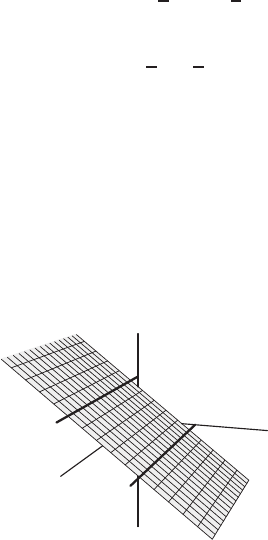
12.4 SOLUTIONS 1177
10. Let the equation of the plane be
z=c+mx +ny
Since we know the points: (4,0,0),(0,3,0), and (0,0,2) are all on the plane, we know that they satisfy the same equation.
We can use these values of (x, y, z)to find c, m, and n. Putting these points into the equation we get:
0 = c+m·4 + n·0so c=−4m
0 = c+m·0 + n·3so c=−3n
2 = c+m·0 + n·0so c= 2
Because we have a value for c, we can solve for mand nto get
c= 2, m =−1
2, n =−2
3.
So the linear function is
z= 2 −1
2x−2
3y.
11. Figure 12.110 shows the two lines the plane must contain.
Both lines are parallel to the x-axis; thus our plane must have x-slope zero. On the other hand, the line in the xy-plane
is 2 units down and one unit to the right of the line in the xz-plane; hence the y-slope of our plane must be −2. Thus the
equation is
z= 0x−2y+c=−2y+c,
for some constant c. Since the plane contains the point (0,0,2), the value of cmust be 2. So the equation is
z=−2y+ 2.
z
x
y
Figure 12.110
12. When y= 0,c+mx = 3x+ 4, so c= 4,m= 3. Thus, when x= 0, we have 4 + ny =y+ 4, so n= 1. Thus,
z= 4 + 3x+y.
13. (a) Since zis a linear function of xand ywith slope 2 in the x-direction, and slope 3 in the y-direction, we have:
z= 2x+ 3y+c
We can write an equation for changes in zin terms of changes in xand y:
∆z= (2(x+ ∆x) + 3(y+ ∆y) + c)−(2x+ 3y+c)
= 2∆x+ 3∆y
Since ∆x= 0.5and ∆y=−0.2, we have
∆z= 2(0.5) + 3(−0.2) = 0.4
So a 0.5 change in xand a −0.2change in yproduces a 0.4 change in z.
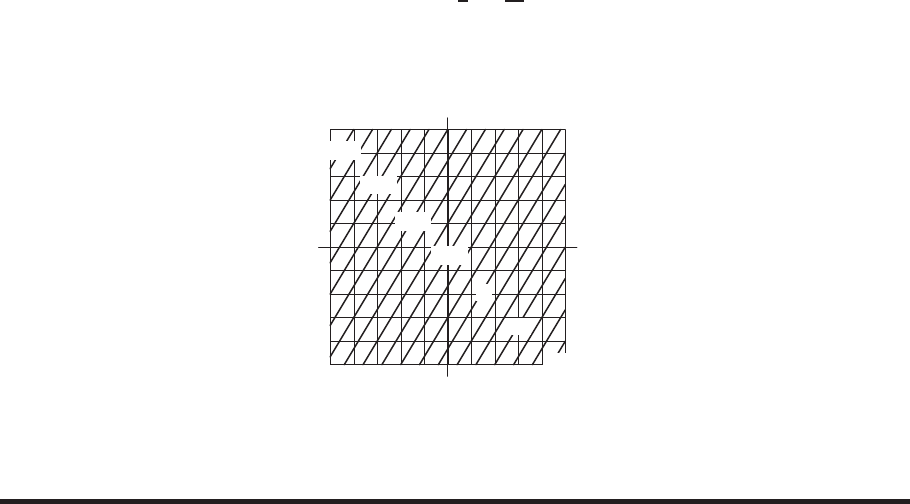
1178 Chapter Twelve /SOLUTIONS
(b) As we know that z= 2 when x= 5 and y= 7, the value of zwhen x= 4.9and y= 7.2will be
z= 2 + ∆z= 2 + 2∆x+ 3∆y
where ∆zis the change in zwhen xchanges from 4.9to 5 and ychanges from 7.2to 7. We have ∆x= 4.9−5 =
−0.1and ∆y= 7.2−7 = 0.2. Therefore, when x= 4.9and y= 7.2, we have
z= 2 + 2 ·(−0.1) + 5 ·0.2 = 2.4
14. (a) Substituting in the values for the slopes, we see that the formula for the plane is z=c+ 5x−3yfor some value of
c. Substituting the point (4,3,−2) gives c=−13. The formula for the plane is
z=−13 + 5x−3y.
(b) When z= 0, we have
0 = −13 + 5x−3y
3y= 5x−13
y=5
3x−13
3.
The contour for z= 0 is a line with slope 5/3 and y-intercept 13/3. Similarly we find other contours. See Fig-
ure 12.111.
−5 5
−5
5
−48
−36
−24
−12
0
12
24
x
y
Figure 12.111
Problems
15. The revenue function, R, is linear and so we may write it as:
R= (p1)c+ (p2)d
where p1is the price of CDs and p2is the price of DVDs, in dollars. From the diagram, we can pick two points, such as
c= 100, d = 100 on the contour R= 2000, and c= 50, d = 300 on the contour R= 4000. These points give the
following system of linear equations:
2000 = 100p1+ 100p2
4000 = 50p1+ 300p2.
Solving gives p1= 8 dollars and p2= 12 dollars.
16. (a) Yes.
(b) The coefficient of mis 15 dollars per month. It represents the monthly charge to use this service. The coefficient of t
is 0.05 dollars per minute. Each minute the customer is on-line costs 5 cents.
(c) The intercept represents the base charge. It costs $35 just to get hooked up to this service.
(d) We have f(3,800) = 120. A customer who uses this service for three months and is on-line for a total of 800 minutes
is charged $120.
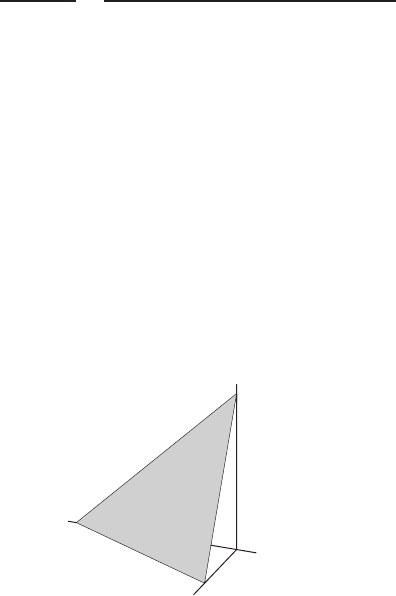
12.4 SOLUTIONS 1179
17. (a) Expenditure, E, is given by the equation:
E= (price of raw material 1)m1+ (price of raw material 2)m2+C
where Cdenotes all the other expenses (assumed to be constant). Since the prices of the raw materials are constant,
but m1and m2are variables, we have a linear function.
(b) Revenue, R, is given by the equation:
R= (p1)q1+ (p2)q2.
Since p1and p2are constant, while q1and q2are variables, we again have a linear function.
(c) Revenue is again given by the equation,
R= (p1)q1+ (p2)q2.
Since p2and q2are now constant, the term (p2)q2is also constant. However, since p1and q1are variables, the (p1)q1
term means that the function is not linear.
18. The data in Table 12.10 is apparently linear with a slope in the wdirection of about 0.9calories burned for every extra
20 lbs of weight, and a slope in the sdirection of about 1.6calories burned for every extra mile per hour of speed. Since
B= 4.2when w= 120 and s= 8, a formula for Bis
B= 4.2 + 0.9(w−120) + 1.6(s−8).
The formula does not make sense for low weights or speeds. For example, it says that a person weighing 120 pounds
going 5 mph burns a negative number of calories per minute, as would a person (child) weighing 60 lbs and going 7 mph.
19. The time in minutes to go 10 miles at a speed of smph is (10/s)(60) = 600/s. Thus the 120 lb person going 10 mph
uses (7.4)(600/10) = 444 calories, and the 180 lb person going 8 mph uses (7.0)(600/8) = 525 calories. The 120 lb
person burns 444/120 = 3.7calories per pound for the trip, while the 180 lb person burns 525/180 = 2.9calories per
pound for the trip.
20. A trip of 10 miles at smph takes 10/s hours = 600/s minutes. Since the number of calories burned per minute is B, the
total number of calories burned on the trip is B·600/s. Thus
P=B(600/s)
w=600(4.2 + 0.9(w−120) + 1.6(s−8))
sw
21. The function, g, has a slope of 3in the xdirection and a slope of 1in the ydirection, so g(x, y) = c+ 3x+y. Since
g(0,0) = 0, the formula is g(x, y) = 3x+y.
22. The function hdecreases as yincreases: each increase of yby 2takes you down one contour and hence changes the
function by 2, so the slope in the ydirection is −1. The slope in the xdirection is 2, so the formula is h(x, y) = c+2x−y.
From the diagram we see that h(0,0) = 4, so c= 4. Therefore, the formula for this linear function is h(x, y) = 4+2x−y.
23. For each column in the table, we find that as xincreases by 1,f(x, y)increases by 2, so the xslope is 2. For each row in
the table, we find that as yincreases by 1,f(x, y)decreases by 0.5, so the yslope is −0.5. So the function has the form
f(x, y) = 2x−0.5y+c. Also note that f(0,0) = 1, so c= 1. Therefore, the function is f(x, y) = 2x−0.5y+ 1.
24. For each column in the table, we find that as xincreases by 100,f(x, y)decreases by 1, so the xslope is −0.01. For
each row in the table, we find that as yincreases by 10,f(x, y)increases by 3, so the yslope is 0.3. So the function
has the form f(x, y) = −0.01x+ 0.3y+c. Also note that f(100,10) = 3, so c= 1. Therefore, the function is
f(x, y) = −0.01x+ 0.3y+ 1
25. See Figure 12.112.
x
y
z
1
−2
2
Figure 12.112

1180 Chapter Twelve /SOLUTIONS
26. See Figure 12.113.
x2y
1
z
2
Figure 12.113
27. See Figure 12.114.
x
y
z
2
−4
4
Figure 12.114
28. See Figure 12.115.
x
y
z
3
6
2
Figure 12.115
29. (a) The contours of fhave equation
k=c+mx +ny, where kis a constant.
Solving for ygives:
y=−m
nx+k−c
n
Since c, m, n and kare constants, this is the equation of a line. The coefficient of xis the slope and is equal to −m/n.
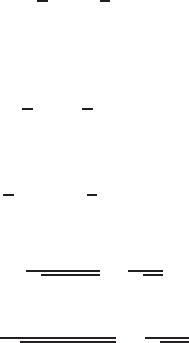
12.4 SOLUTIONS 1181
(b) Substituting x+nfor xand y−mfor yinto f(x, y)gives
f(x+n, y −m) = c+m(x+n) + n(y−m)
Multiplying out and simplifying gives
f(x+n, y −m) = c+mx +mn +ny −nm
f(x+n, y −m) = c+mx +ny =f(x, y)
(c) Part (b) tells us that if we move nunits in the xdirection and −munits in the ydirection, the value of the function
f(x, y)remains constant. Since contours are lines where the function has a constant value, this implies that we remain
on the same contour. This agrees with part (a) which tells us that the slope of any contour line will be −m/n. Since
the slope is ∆y/∆x, it follows that changing yby −mand xby nwill keep us on the same contour.
30. (a) We see always the same change in z, namely ∆z= 7, for each step through the table in this diagonal direction. For
example, in the third step of the diagonal starting at 3we get 24 −17 = 7, and in the second step of the diagonal
starting at 6we get 20 −13 = 7.
(b) We see always the same change in z, namely ∆z=−5, for each step in this direction. For example, in the second
step starting from 19 we get 9−14 = −5, and in the first step starting at 22 we get 17 −22 = −5.
(c) For a linear function, z=mx +ny +c, we have:
z1−z2= (mx1+ny1+c)−(mx2+ny2+c) = m(x1−x2) + n(y1−y2).
Writing ∆z=z1−z2, and ∆x=x1−x2, and ∆y=y1−y2, we have
∆z=m∆x+n∆y.
For the particular linear function in this problem, we have
∆z=4
5∆x+3
2∆y.
In part (a), as we move down the diagonal, we are taking steps with the same ∆x= 5 and same ∆y= 2. Therefore
we will get the same change in zfor each step,
∆z=4
5(5) + 3
2(2) = 7.
In part (b), for each step we have ∆x=−10 and ∆y= 2, so for each step
∆z=4
5(−10) + 3
2(2) = −5.
31. (a) We have ∆z= 7. Thus
Slope =7
√52+ 22=7
√29 .
(b) We have ∆z=−5. Thus
Slope =−5
p(−10)2+ 22=−5
√104 .
32. Graph (I) has contour lines that slope upward from left to right, so it corresponds to h,j,k, or m. Since the values on the
contour lines are increasing with xand decreasing with y, Graph (I) corresponds to hor j. Since (0,0,12) is a point on
the contours of hbut not of jfor −2≤x, y ≤2, the values on the contour lines show that Graph (I) corresponds to h.
Graph (II) has contour lines that slope downward from left to right, so it corresponds to f,g,n, or p. Since the values
on the contour lines are decreasing with xand with y, Graph (II) corresponds to nor p. Since (0,0,14) is a point on the
contours of nbut not of pfor −2≤x, y ≤2, the values on the contour lines show that Graph (II) corresponds to n.
Graph (III) has contour lines that slope downward from left to right, so it corresponds to f,g,n, or p. Since the
values on the contour lines are increasing with xand with y, Graph (III) corresponds to for g. Since (0,0,10) is a point
on the contours of fbut not of gfor −2≤x, y ≤2, the values on the contour lines show that Graph (III) corresponds to
f.
Graph (IV) has contour lines that slope upward from left to right, so it corresponds to h,j,k, or m. Since the values
on the contour lines are increasing with yand decreasing with x, Graph (IV) corresponds to kor m. Since (0,0,60) is
a point on the contours of mbut not of kfor −2≤x, y ≤2, the values on the contour lines show that Graph (IV)
corresponds to m.
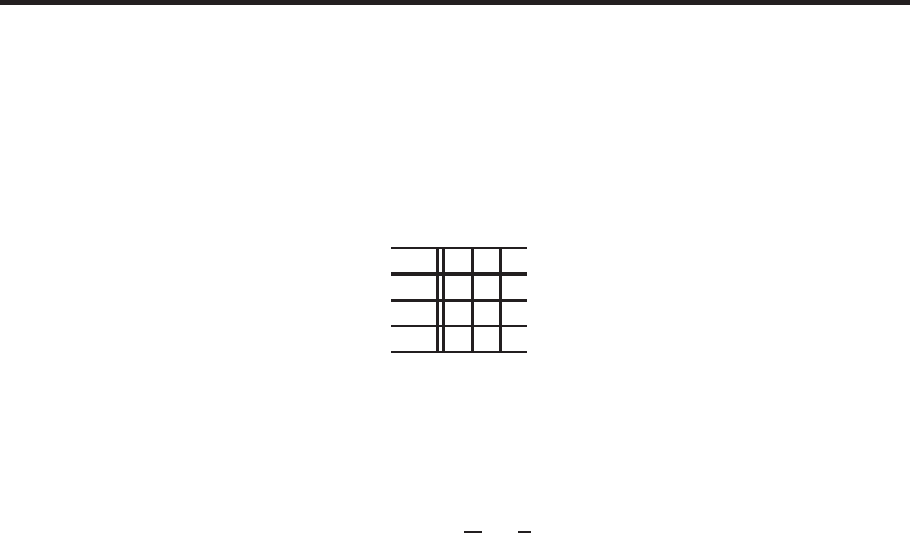
1182 Chapter Twelve /SOLUTIONS
Strengthen Your Understanding
33. The function f(x, y) = ex+yhas contours that are parallel lines x+y=c, but it is not linear. This example generalizes
to g(x+y)for any function g(t). The family of functions h(x, y) = r(x)also works, for any function r. There are other
examples.
34. The function f(x, y) = xy has linear cross-sections for both xand yfixed, but it is not linear. Any function of the form
g(x, y) = (mx +b)(ny +c)also satisfies this condition.
35. A possible example is in Table 12.16, where the rows have slopes 1, 2, 3, respectively, and the columns have slopes 1, 2,
3. Notice that the function is not linear since the slopes in each row (and in each column) are different.
Table 12.16
x\y12 3
1123
2 2 4 6
3 3 6 9
36. If the linear function is z=mx +ny +c, then the contour for z= 0 is:
mx +ny +c= 0.
We want this line to have slope 2, so we rewrite it in slope-intercept form:
y=−m
nx−c
n.
Thus, we want −m/n = 2, for example m=−2, n = 1. So z=−2x+yis one example. There are others.
37. False. At every point (x, y)the zcoordinate on the first plane is 2units lower than the second so these planes are parallel
and do not intersect.
38. False. The first row is linear with slope 1/0.1 = 10. The second row is linear with slope 1.07/0.1 = 10.7. Since the
slope of the first row is not the same as the slope of the second row, the function is not linear.
39. False. The contours are of the form c= 3x+ 2ywhich are lines with slope −3/2.
40. True. The contours of a linear function f(x, y) = c+mx +ny look like k=c+mx +ny which are parallel lines with
slope −m/n.
41. True. f(0,0) = 0, f(0,1) = 4 give a yslope of 4, but f(0,0) = 0, f(0,3) = 5 give a yslope of 5/3. Since linearity
means the yslope must be the same between any two points, this function cannot be linear.
42. True. A linear function has constant slopes in the xand ydirections, so its graph is a plane.
43. True. Since the graph of a linear function is a plane, any vertical slice parallel to the yz-plane will yield a line.
44. False. Any function of the form f(x, y) = cis linear (with zero slope in both the xand ydirections) and has a graph
which is parallel to the xy-plane.
45. True. Functions can have only one value for a given input, so their graphs can intersect a vertical line at most once. A
vertical plane would not satisfy this property, so cannot be the graph of a function.
46. False. There is at least one point where f(a, b) = 0, for example (a, b) = (1,1). There are an infinite number of other
points lying on the straight-line contour f(a, b) = 0.
47. False. All of the columns have to have the same slope, as do the rows, but the row slopes can differ from the column
slopes.
48. False. Simply knowing where the plane intersects the xy-plane does not determine the plane uniquely. There are an infinite
number of linear functions whose graph intersects the xy-plane in this line. Two examples: f(x, y) = −1−2x+yand
g(x, y) = −2−4x+ 2y.
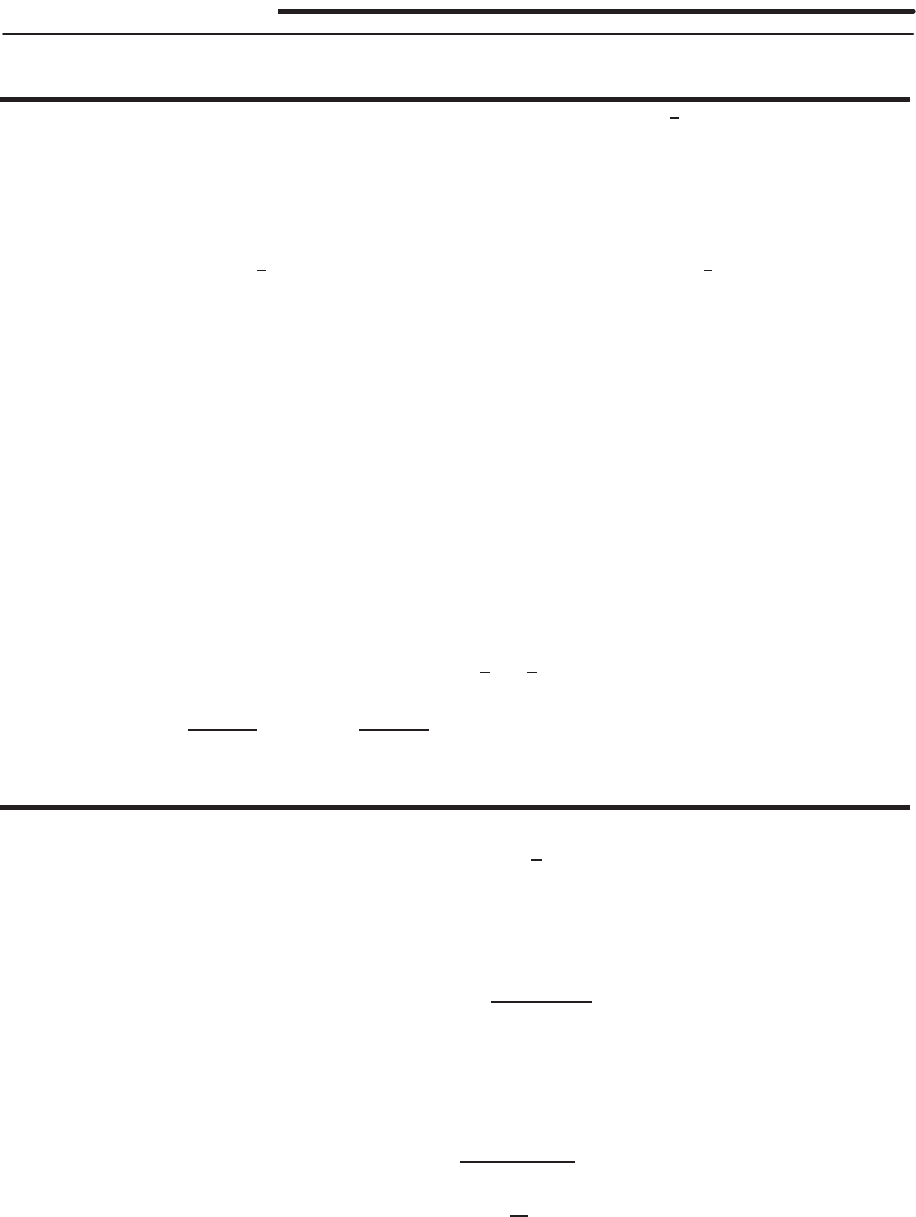
12.5 SOLUTIONS 1183
Solutions for Section 12.5
Exercises
1. (a) Observe that setting f(x, y, z) = cgives a cylinder about the x-axis, with radius √c. These surfaces are in graph (I).
(b) By the same reasoning the level curves for h(x, y, z)are cylinders about the y-axis, so they are represented in graph
(II).
2. Points on one of the nested spheres in II have constant distance from the origin, so these spheres are level surfaces
f(x, y, z) = x2+y2+z2=c. Points on one of the nested cylinders in I have constant distance from the y-axis, so these
cylinders are level surfaces g(x, y, z) = x2+z2=k.
3. If we solve for z, we get z=1
3(5 −x−2y), so the level surface is the graph of f(x, y) = 1
3(5 −x−2y).
4. We are looking for all points (x, y, z)whose distance from the origin is 2, that is, (x−0)2+ (y−0)2+ (z−0)2= 4,
or x2+y2+z2= 4, which is a level surface of f(x, y, z) = x2+y2+z2.
5. If we solve for z, we get z= (1 −x2−y)2, so the level surface is the graph of f(x, y) = (1 −x2−y)2.
6. We are looking for all points (x, y, z)whose distance from (a, b, c)is a constant k, that is, (x−a)2+(y−b)2+(z−c)2=
k2, which is a level surface of f(x, y, z) = (x−a)2+ (y−b)2+ (z−c)2.
7. Only the elliptical paraboloid, the hyperbolic paraboloid and the plane. These are the only surfaces in the catalog that
satisfy the “vertical line test,” that is, they have at most one z-value for each xand y.
8. An elliptic paraboloid.
9. A hyperboloid of two sheets.
10. A plane.
11. An ellipsoid.
12. Yes,
z=f(x, y) = x2+ 3y2.
13. Yes,
z=f(x, y) = 2
5x+3
5y−2.
14. No, because some zvalues correspond to two points on the surface.
15. No, because z=px2+ 3y2and z=−px2+ 3y2, so some z-values correspond to two points on the surface.
Problems
16. The plane is represented by
z=f(x, y) = 2x−y
2−3
and
g(x, y, z) = 4x−y−2z= 6.
Other answers are possible
17. The top half of the sphere is represented by
z=f(x, y) = p10 −x2−y2
and
g(x, y, z) = x2+y2+z2= 10, z ≥0.
Other answers are possible.
18. The bottom half of the ellipsoid is represented by
z=f(x, y) = −p2(1 −x2−y2)
g(x, y, z) = x2+y2+z2
2= 1, z ≤0.
Other answers are possible
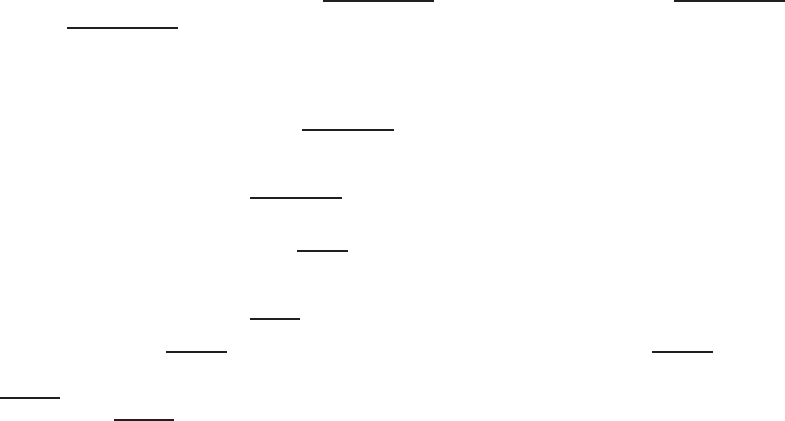
1184 Chapter Twelve /SOLUTIONS
19. (a) The isothermal surfaces of fare parallel planes. Each plane is described by the equation
2x−3y+z=c+ 20,
for each value of the constant c.
(b) We have:
fz(0,0,0) = 1.
This means that if we start at the point (0,0,0) and move slightly upwards in the direction of the positive z-axis, our
temperature is increasing by one degree Fahrenheit for each additional unit we move.
(c) To increase our temperature the fastest we should move away from the isothermal plane passing through (0,0,0)
in a direction that allows us to reach the warmer isothermal planes as fast as possible. This means that we should
follow a normal vector to the isothermal plane passing through (0,0,0) that has a positive ~
kcomponent (temperature
increases with cand c+ 20 gives the z-intercept of each isothermal plane). We have:
Isothermal plane through (0,0,0) : 2x−3y+z= 20,
Normal vector to isothermal plane through (0,0,0) : ~n = 2
~
i−3~
j+~
k .
So, we must move away from the origin in the direction of the vector 2
~
i−3~
j+~
k.
(d) Isothermal surfaces of fare of the form
z=c+ 20 −2x+ 3y,
so, setting c=−3, we see that f(x, y) = −2x+ 3y+ 17 is an isothermal surface of f. On this surface the
temperature is −3degrees Fahrenheit.
20. (a) We expect Bto be an increasing function of all three variables.
(b) A deposit of $1250 at a 1% annual interest rate leads to a balance of $1276 after 25 months.
21. We expect Pto be an increasing function of Aand r. (If you borrow more, your payments go up; if the interest rates go
up, your payments go up.) However, Pis a decreasing function of t. (If you spread out your payments over more years,
you pay less each month.)
22. The graph of g(x, y) = x+ 2yis the set of all points (x, y, z)satisfying z=x+ 2y, or x+ 2y−z= 0.This is a level
surface, but we want the surface equal to the constant value 1, not 0, so we can add 1 to both sides to get x+2y−z+1 = 1.
Thus, f(x, y, z) = x+ 2y−z+ 1 has level surface f= 1 identical to the graph of g(x, y) = x+ 2y.
23. If we solve x2+y2/4+z2/9 = 1 for zwe get z=±3p1−x2−y2/4. Thus we can take f(x, y) = 3p1−x2−y2/4
and g(x, y) = −3p1−x2−y2/4.
24. The equation of any plane parallel to the plane z= 2x+3y−5has x-slope 2 and y-slope 3, so has equation z= 2x+3y−c
for any constant c, or 2x+ 3y−z=c. Thus we could take g(x, y, z) = 2x+ 3y−z. Other answers are possible.
25. (a) The graph of f(x, y)is obtained by plotting points (x, y, z), where z=f(x, y). Since the square root function is
never negative, we have z≥0. Setting z=p1−x2−y2and squaring both sides leads to x2+y2+z2= 1,
which is the equation for a sphere of radius 1. The graph of the function includes only those points where z≥0, that
is, the upper hemisphere of radius 1, centered at the origin.
(b) If we take g(x, y, z) = f(x, y)−z=p1−x2−y2−z, then the level surface g(x, y, z) = 0 is the surface S.
26. (a) The graph of f(x, y)is obtained by plotting points (x, y, z), where z=f(x, y). Since the square root function is
never negative, we have z≥0. Setting z=p1−y2and squaring both sides leads to y2+z2= 1, which is the
equation for a circular cylinder of radius 1 lying along the x-axis (since xis missing from the equation). The graph
of the function includes only those points where z≥0, that is, the upper half of the cylinder.
(b) If we take g(x, y, z) = f(x, y)−z=p1−y2−z, then the level surface g(x, y, z) = 0 is the surface S.
27. Starting with the equation z=px2+y2, we flip the cone and shift it up one, yielding z= 1 −px2+y2.This is a
cone with vertex at (0,0,1) that intersects the xy-plane in a circle of radius 1. Interchanging the variables, we see that
y= 1 −√x2+z2is an equation whose graph includes the desired cone C. Finally, we express this equation as a level
surface g(x, y, z) = 1 −√x2+z2−y= 0.
28. In the xz-plane, the equation x2/4 + z2= 1 is an ellipse, with widest points at x=±2on the x-axis and crossing the
z-axis at z=±1.Since the equation has no yterm, the level surface is a cylinder of elliptical cross-section, centered
along the y-axis.
29. Setting yto a constant cyields the equation x2+z2= 1 −c2/4, which, for −2≤c≤2gives circular cross-sections.
Fixing x=cyields the equation y2/4 + z2= 1 −c2, which for −1≤c≤1yields elliptical cross-sections. A similar
result is true for cross-sections with constant z. Thus the level surface appears to be a unit sphere, centered at the origin,
that has been stretched by a factor of two in the y-direction (this shape is called an ellipsoid).
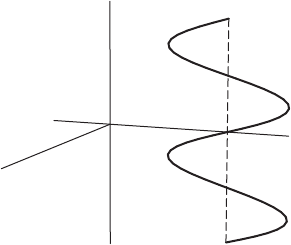
12.5 SOLUTIONS 1185
30. The level surfaces are graphs of the equations x+y+z=cfor different values of the constant c. These are all parallel
planes.
31. The level surfaces are the graphs of sin(x+y+z) = kfor constant k(with −1≤k≤1). This means x+y+z=
sin−1(k) + 2πn, or π−sin−1(k) + 2nπ for all integers n. Therefore for each value of k, with −1≤k≤1, we get an
infinite family of parallel planes. So the level surfaces are families of parallel planes.
32. Let’s consider the function y= 2 + sin zdrawn in the yz-plane in Figure 12.116.
x
y
z
y= 2 + sin z
2
Figure 12.116
Now rotate this graph around the z-axis. Then, a point (x, y, z)is on the surface if and only if x2+y2= (2+sin z)2.
Thus, the surface generated is a surface of rotation with the profile shown in Figure 12.116.
Similarly, the surface with equation x2+y2= (f(z))2is the surface obtained rotating the graph of y=f(z)around
the z-axis.
33. f(x, y, z) = x2−y2+z2has 3 types of level surfaces depending on the values of cin the equation x2−y2+z2=c.
We write this as x2+z2=y2+cand think of what happens as we take a cross-section of the surface, perpendicular to
the y-axis by holding yfixed.
(i) For c > 0, the level surface is a hyperboloid of 1 sheet.
(ii) For c < 0, the level surface is a hyperboloid of 2 sheets.
(iii) For c= 0, the level surface is a cone.
34. The level surfaces are the graphs of g(x, y, z) = e−(x2+y2+z2)=kfor constant values of ksuch that 0< k ≤1.So
x2+y2+z2=−ln k, which is the graph of a sphere since −ln k≥0.
35. The level surfaces are all planes described as follows:
When h(x, y, z) = 1, the plane is given by
ez−y= 1,so z−y= ln 1 = 0.
When h(x, y, z) = e, the plane is given by
ez−y=e, so z−y= ln e= 1.
When h(x, y, z) = e2, the plane is given by
ez−y=e2,so z−y= ln e2= 2.
See Figure 12.117.
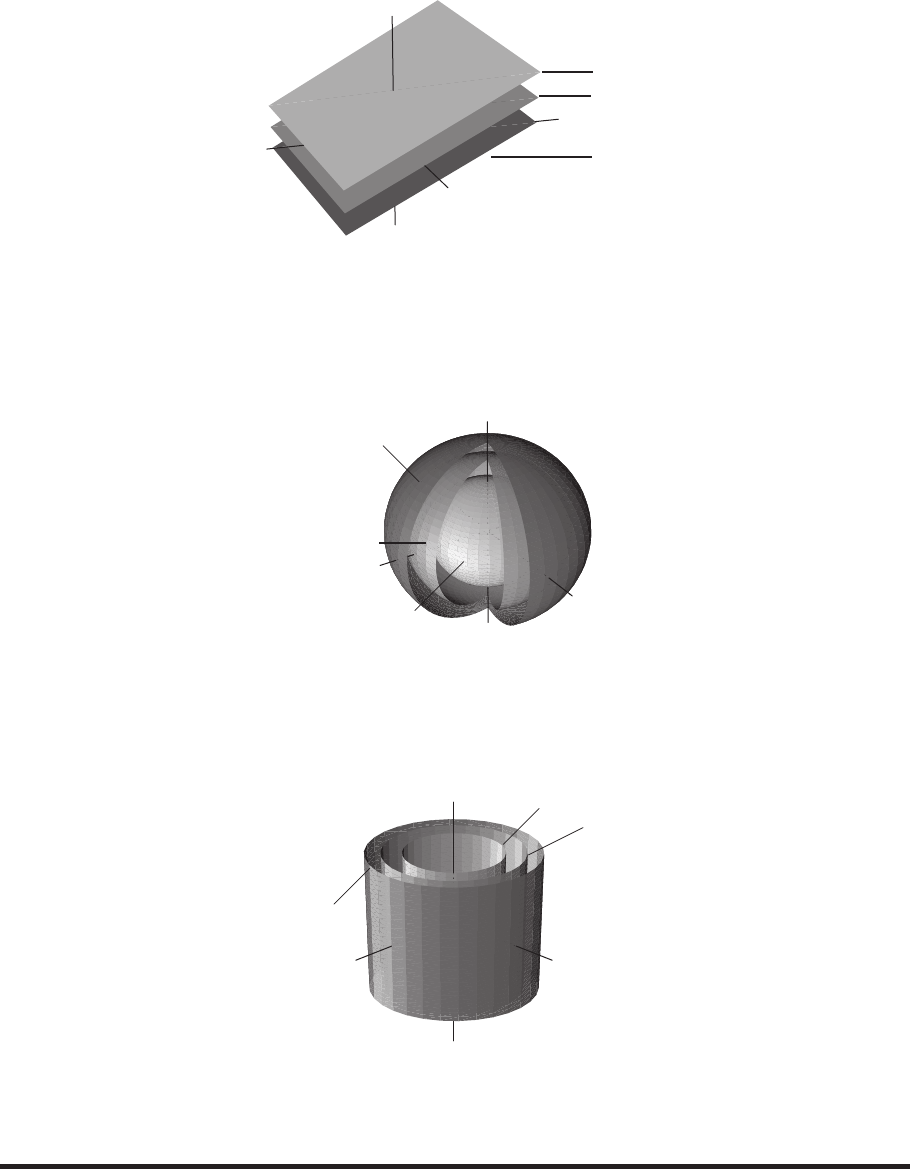
1186 Chapter Twelve /SOLUTIONS
x
y
z
✛h=e2
✛h=e
✛h= 1
Figure 12.117
36. For values of f < 4, the level surfaces are spheres, with larger fgiving smaller radii. See Figure 12.118.
y
z
x✒
f= 2
✲
f= 1
❘
f= 0
Figure 12.118
37. For values of g < 1, the level surfaces are cylinders centered on the z-axis, with larger gvalues giving smaller radii. See
Figure 12.119.
xy
z
✠
g= 0
✙
g=−1
✒
g=−2
Figure 12.119
Strengthen Your Understanding
38. The graph of f(x, y, z)is all points (x, y, z, w)in 4-space such that w=f(x, y, z). This graph cannot be drawn in
3-space; it would need 4 dimensions.
39. Since zis missing in the formula for f(x, y, z), the level surface f(x, y, z) = x2−y2=cis a hyperbolic cylinder. All
its cross-sections perpendicular to the z-axis are the same hyperbola x2−y2=c.
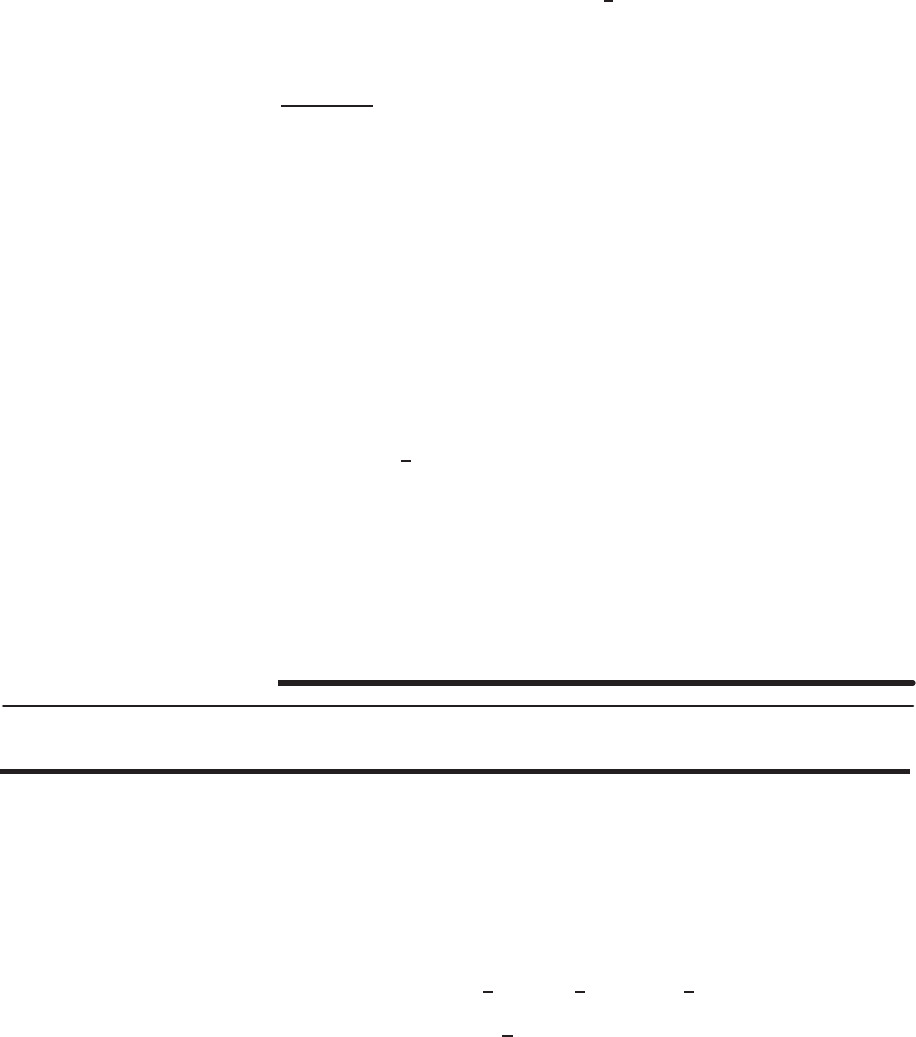
12.6 SOLUTIONS 1187
40. Since zis missing in the formula for f(x, y, z), the level surface f(x, y, z) = x2+y2=cis a cylinder running along
the z-axis.
41. A linear function of three variables has level surfaces that are equally spaced planes. Choosing a linear function that does
not depend on xgives level surfaces perpendicular to the yz-plane. The function f(x, y, z) = y+z, for example, works.
Its level surfaces are the planes: c=y+z, or z=−y+c.
42. A cylinder centered on the y-axis has equation x2+z2=c, so we take f(x, y, z) = x2+z2. There are other possible
answers.
43. Let f(x, y, z) = (x+y+z)2. Then f(x, y, z) = c≥0means x+y+z=√c, which for different care parallel planes.
44. One family of paraboloids is given by equations of the form z=x2+y2−c, where cis a constant. Rearranging this
equation, we obtain x2+y2−z=c. Therefore, the level sets of the function f(x, y, z) = x2+y2−zare paraboloids.
45. True. Both are the set of all points (x, y, z)in 3-space satisfying z=x2+y2.
46. False. The graph of f(x, y) = p1−x2−y2is the upper unit hemisphere, while the graph of g= 1 is x2+y2+z2= 1,
which is the entire unit sphere (both spheres with center at the origin).
47. True. The graph of f(x, y)is the set of all points (x, y, z)satisfying z=f(x, y). If we define the three-variable function
gby g(x, y, z) = f(x, y)−z, then the level surface g= 0 is exactly the same as the graph of f(x, y).
48. False. For example, the function g(x, y, z) = x2+y2+z2has level surface g= 1 which is a sphere of radius 1, centered
at the origin. This surface cannot be the graph of any function f(x, y), since a vertical line intersects it in more than one
place.
49. True. The level surfaces are of the form x+ 2y+z=k, or z=k−x−2y. These are the graphs of the linear functions
f(x, y) = k−x−2y, each of which has x-slope of −1and y-slope equal to −2. Thus they form parallel planes.
50. False. The level surfaces are of the form x2+y+z2=k, or y=k−x2−z2. These are paraboloids centered on the
y-axis, not cylinders.
51. False. The level surface g= 0 of the function g(x, y, z) = x2+y2+z2consists of only the origin.
52. True. The level surfaces g=kare of the form ax +by +cz +d=k, or
z=1
c(−ax −by + (k−d)).
Thus zis a linear function of xand y, whose graph is a plane.
53. False. For example, the function g(x, y, z) = sin(x+y+z)has level surfaces of the form x+y+z=k, where
k= arcsin(c) + nπ, for n= 0,±1,±2, . . .. These surfaces are planes (for −1≤c≤1).
54. True. If there is a point (a, b, c)lying on both g(x, y, z) = k1and g(x, y, z) = k2, then we must have g(a, b, c) = k1
and g(a, b, c) = k2. Since gis a function, it can only have a single value at a point, so k1=k2.
Solutions for Section 12.6
Exercises
1. No, 1/(x2+y2)is not defined at the origin, so is not continuous at all points in the square −1≤x≤1,−1≤y≤1.
2. The function 1/(x2+y2)is continuous on the square 1≤x≤2,1≤y≤2. The functions x2and y2are continuous
everywhere, and so is their sum. The constant function 1is continuous, and thus so is the ratio 1/(x2+y2), as long as
x2+y26= 0. Since the only place x2+y2= 0 is at the origin, and the origin is not included in the square, the function
is continuous in the square.
3. The function y/(x2+ 2) is continuous on the disk x2+y2≤1. The functions x2+ 2 and yare continuous everywhere,
and so is their ratio, as long as the denominator is not 0. But x2+ 2 is always at least 2, so the function is continuous on
the disk (actually at all points in the plane).
4. The function esin x/cos yis continuous on the rectangle −π
2≤x≤π
2,0≤y≤π
4. The functions sin xand ex
are continuous everywhere, and so is their composition esin x.Then the ratio esin x/cos yis continuous as long as the
denominator is not 0. But cos yis not 0 in the interval 0≤y≤π
4, so the function is continuous on the given rectangle.
5. The function tan(θ)is undefined when θ=π/2≈1.57. Since there are points in the square −2≤x≤2,−2≤y≤2
with x·y=π/2(e.g. x= 1, y =π/2) the function tan(xy)is not defined inside the square, hence not continuous.
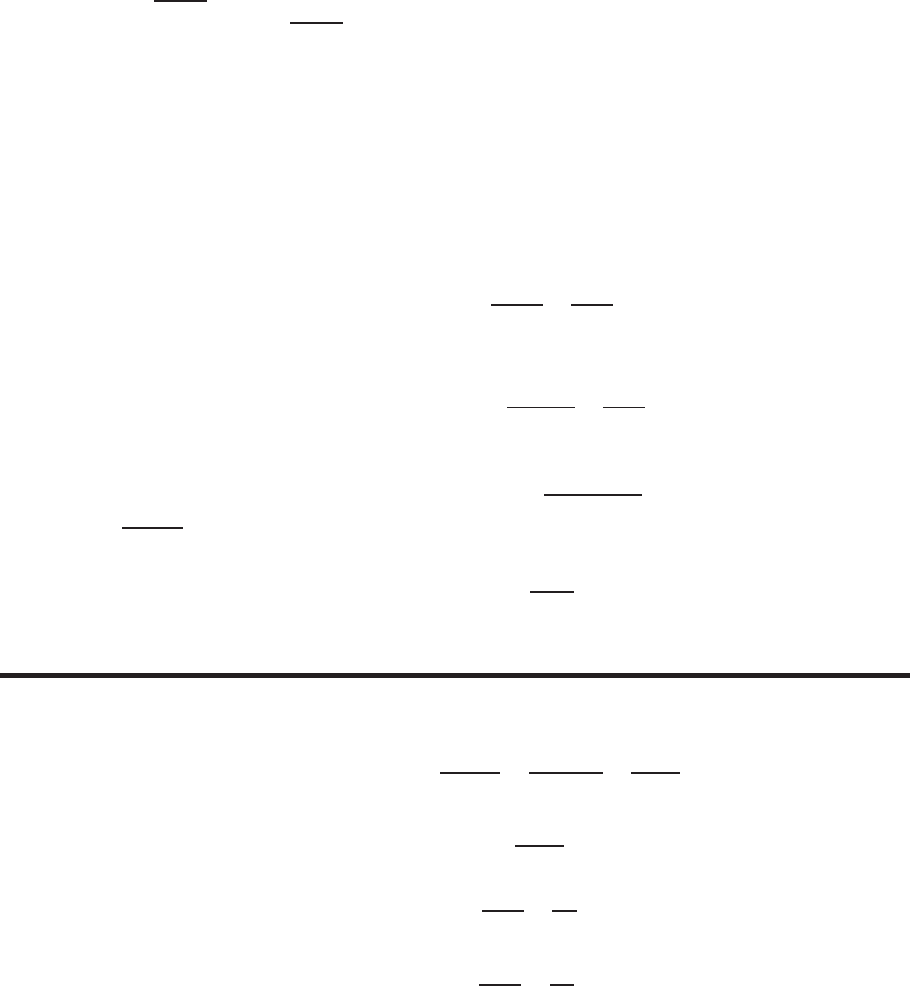
1188 Chapter Twelve /SOLUTIONS
6. The function √2x−yis undefined when 2x−y < 0.Since there are points in the disk x2+y2≤4with 2x−y < 0
(e.g. x= 0, y = 1) the function √2x−yis not defined at all points inside the disk and hence is not continuous.
7. Since the composition of continuous functions is continuous, the function fis continuous at (0,0) and we have
lim
(x,y)→(0,0) f(x, y) = lim
(x,y)→(0,0) e−x−y=e−0−0= 1
8. Since the composition of continuous functions is continuous, the function fis continuous at (0,0). We have:
lim
(x,y)→(0,0) f(x, y) = lim
(x,y)→(0,0)(x2+y2) = 0 + 0 = 0.
9. Since fdoes not depend on ywe have:
lim
(x,y)→(0,0) f(x, y) = lim
x→0
x
x2+ 1 =0
0 + 1 = 0.
10. Since the composition of continuous functions is continuous, the function fis continuous at (0,0). We have:
lim
(x,y)→(0,0) f(x, y) = lim
(x,y)→(0,0)
x+y
sin y+ 2 =0 + 0
0 + 2 = 0.
11. We want to compute
lim
(x,y)→(0,0) f(x, y) = lim
(x,y)→(0,0)
sin(x2+y2)
x2+y2.
As r=px2+y2is the distance from (x, y)to (0,0) we have that (x, y)→(0,0) is equivalent to r→0. Hence the
limit becomes:
lim
(x,y)→(0,0) f(x, y) = lim
r→0
sin r2
r2= 1.
Problems
12. We want to show that fdoes not have a limit as (x, y)approaches (0,0). So let us suppose that (x, y)tends to (0,0)
along the line y=mx, where the slope m6= 1. Then
f(x, y) = f(x, mx) = x+mx
x−mx =(1 + m)x
(1 −m)x=1 + m
1−m.
Therefore
lim
x→0f(x, mx) = 1 + m
1−m
and so for m= 2 we get
lim
(x,y)→(0,0)
y=2x
f(x, y) = 1 + 2
1−2=3
−1=−3
and for m= 3
lim
(x,y)→(0,0)
y=3x
f(x, y) = 1 + 3
1−3=4
−2=−2.
Thus no matter how close they are to the origin, there will be points (x, y)where the value f(x, y)is close to −3and
points (x, y)where f(x, y)is close to −2. So the limit:
lim
(x,y)→(0,0) f(x, y)does not exist.
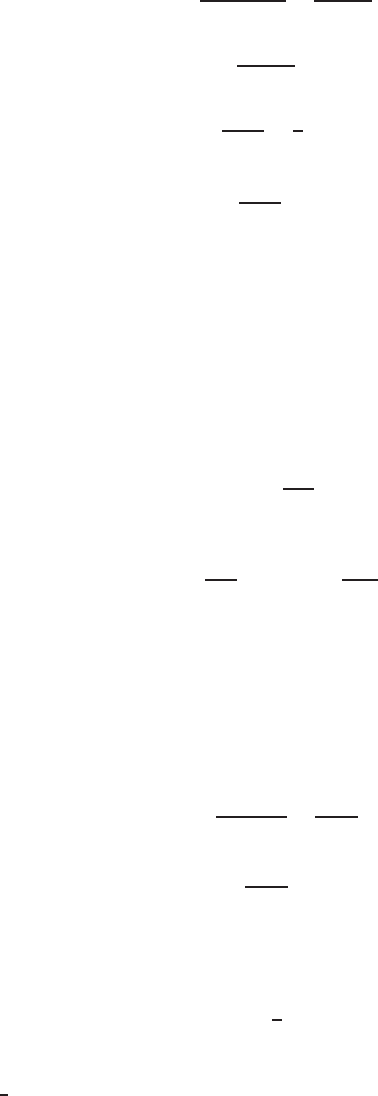
12.6 SOLUTIONS 1189
13. We want to show that fdoes not have a limit as (x, y)approaches (0,0). Let us suppose that (x, y)tends to (0,0) along
the line y=mx. Then
f(x, y) = f(x, mx) = x2−m2x2
x2+m2x2=1−m2
1 + m2.
Therefore
lim
x→0f(x, mx) = 1−m2
1 + m2
and so for m= 1 we get
lim
(x,y)→(0,0)
y=x
f(x, y) = 1−1
1 + 1 =0
2= 0
and for m= 0
lim
(x,y)→(0,0)
y=0
f(x, y) = 1−0
1 + 0 = 1.
Thus no matter how close they are to the origin, there will be points (x, y)such that f(x, y)is close to 0and points (x, y)
where f(x, y)is close to 1. So the limit:
lim
(x,y)→(0,0) f(x, y)does not exist.
14. Points along the positive x-axis are of the form (x, 0); at these points the function looks like 2x/2x= 1 everywhere
(except at the origin, where it is undefined). On the other hand, along the y-axis, the function looks like −y2/y2=−1.
Since approaching the origin along two different paths yields numbers that are not the same, the limit does not exist.
15. We want to show that fdoes not have a limit as (x, y)approaches (0,0). For this let us consider x > 0,y > 0, which
gives
lim
(x,y)→(0,0)
x>0,y>0
f(x, y) = lim
(x,y)→(0,0)
x>0,y>0
xy
|xy|= 1.
On the other hand, if x > 0,y < 0, we get
lim
(x,y)→(0,0)
x>0,y<0
f(x, y) = lim
(x,y)→(0,0)
x>0,y<0
xy
|xy|= lim
(x,y)→(0,0)
x>0,y<0
xy
−xy =−1.
Thus no matter how close to the origin they are, there will be points (x, y)such that f(x, y)is close to 1and points (x, y)
such that f(x, y)is close to −1. So the limit
lim
(x,y)→(0,0) f(x, y)does not exist.
16. Let us suppose that (x, y)tends to (0,0) along the curve y=kx2, where k6=−1. We get
f(x, y) = f(x, kx2) = x2
x2+kx2=1
1 + k.
Therefore:
lim
x→0f(x, kx2) = 1
1 + k
and so for k= 0 we get
lim
(x,y)→(0,0)
y=0
f(x, y) = 1
and for k= 1
lim
(x,y)→(0,0)
y=x2
f(x, y) = 1
2.
Thus no matter how close they are to the origin, there will be points (x, y)where the value f(x, y)is close to 1and points
(x, y)where f(x, y)is close to 1
2. So the limit:
lim
(x,y)→(0,0) f(x, y)
does not exist.
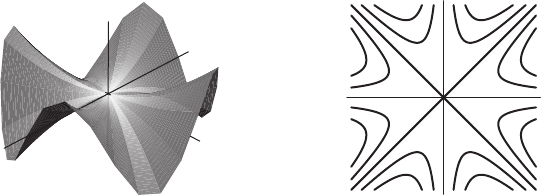
1190 Chapter Twelve /SOLUTIONS
17. For x > 0, we have
f(x, y) = y.
Thus, the surface representing ffor x > 0is the plane z=y.
For x < 0, we have
f(x, y) = −y.
Thus, the surface representing ffor x < 0is the plane z=−y.
For x= 0, we have
f(x, y) = 0.
Thus, the surface representing fis two half-planes and the y-axis.
(a) The function is continuous at every point on the x-axis.
(b) The function is not continuous at any point on the y-axis, except at the origin, because f(x, y) = 0 on the y-axis and
not nearby unless y= 0.
(c) The function is continuous at the origin.
(a) Yes
(b) No
(c) Yes
18. The function, fis continuous at all points (x, y)with x6= 3. We analyze the continuity of fat the point (3, a). We have:
lim
(x,y)→(3,a),x<3f(x, y) = lim
y→a(c+y) = c+a
lim
(x,y)→(3,a),x>3f(x, y) = lim
x>3,x→3(5 −x) = 2.
We want to see if we can find one value of csuch that c+a= 2 for all a. This would mean that c= 2 −a, but then c
would be dependent on a. Therefore, we cannot make the function continuous everywhere.
19. The function fis continuous at all points (x, y)with x6= 3. So let’s analyze the continuity of fat the point (3, a). We
have
lim
(x,y)→(3,a)
x<3
f(x, y) = lim
y→a(c+y) = c+a
lim
(x,y)→(3,a)
x>3
f(x, y) = lim
y→a(5 −y) = 5 −a.
So we need to see if we can find one value for csuch that c+a= 5 −afor all a. This would require that c= 5 −2a,
but then cwould depend on a, which is exactly what we don’t want. Therefore, we cannot make the function continuous
everywhere.
20. It is not continuous at (0,0). The function f(x, y) = x2+y2gets closer and closer to 0 as (x, y)gets closer to the
origin; but the value of f(0,0) is not 0, it is 2. Since the value of the function is not equal to the limit, the function is not
continuous at the origin.
21. The function f(x, y) = x2+y2+ 1 gets closer and closer to 1 as (x, y)gets closer to the origin. To make fcontinuous
at the origin, we need to have f(0,0) = 1.Thus c= 1 will make the function continuous at the origin.
22. (a) The graphs are shown in Figure 12.120.
xy
z
y
x
Figure 12.120
(b) Yes, it seems that if xand yare both close to 0, the values of the function are both close to 0 = f(0,0).
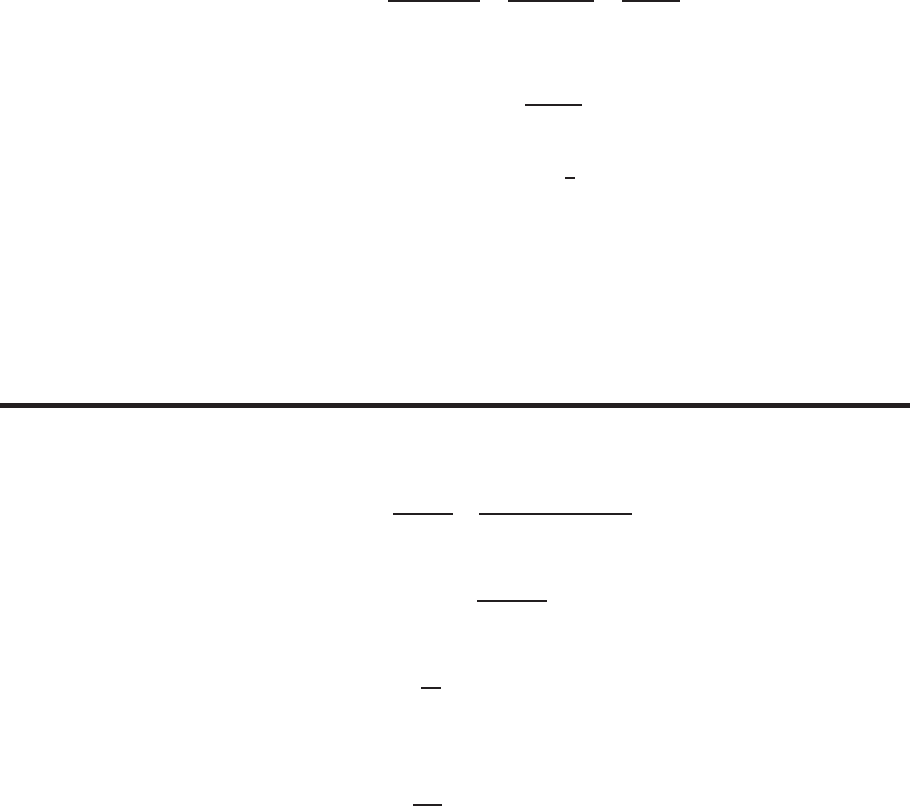
12.6 SOLUTIONS 1191
23. (a) We have f(x, 0) = 0 for all xand f(0, y) = 0 for all y, so these are both continuous (constant) functions of one
variable.
(b) The contour diagram suggests that the contours of fare lines through the origin. Providing it is not vertical, the
equation of such a line is
y=mx.
To confirm that such lines are contours of f, we must show that fis constant along these lines. Substituting into the
function, we get
f(x, y) = f(x, mx) = x(mx)
x2+ (mx)2=mx2
x2+m2x2=m
1 + m2=constant.
Since f(x, y)is constant along the line y=mx, such lines are contained in contours of f.
(c) We consider the limit of f(x, y)as (x, y)→(0,0) along the line y=mx. We can see that
lim
x→0f(x, mx) = m
1 + m2.
Therefore, if m= 1 we have
lim
(x,y)→(0,0)
y=x
f(x, y) = 1
2
whereas if m= 0 we have
lim
(x,y)→(0,0)
y=0
f(x, y) = 0.
Thus, no matter how close we are to the origin, we can find points (x, y)where the value f(x, y)is 1/2and points
(x, y)where the value f(x, y)is 0. So the limit lim(x,y)→(0,0) f(x, y)does not exist. Thus, fis not continuous at
(0,0), even though the one-variable functions f(x, 0) and f(0, y)are continuous at (0,0). See Figures 23 and 23
Strengthen Your Understanding
24. For continuity, one also needs the value of the limit to be the same as f(a, b).
25. For the quotient f/g, one also needs g(a, b)6= 0.
26. Let
f(x, y) = 1
x2+y2+1
(x−1)2+ (y−2)2.
27. Let
f(x, y) = x2+ 2y2
x2+y2.
Approaching along the x-axis means setting y= 0, so then
f(x, y) = x2
x2= 1 for all x6= 0.
Thus, the limit approaching (0,0) along the x-axis is 1.
Approaching along the y-axis means setting x= 0, so then
f(x, y) = 2y2
y2= 2,for all y6= 0.
Thus, the limit approaching (0,0) along the y-axis is 2.
28. One possible answer is f(x, y) = (0if x < 2
1if x≥2.
29. One possible answer if f(x, y) = 1/((x−2)2+y2).
30. One possible answer is f(x, y) = 1/(x2+y2−1).
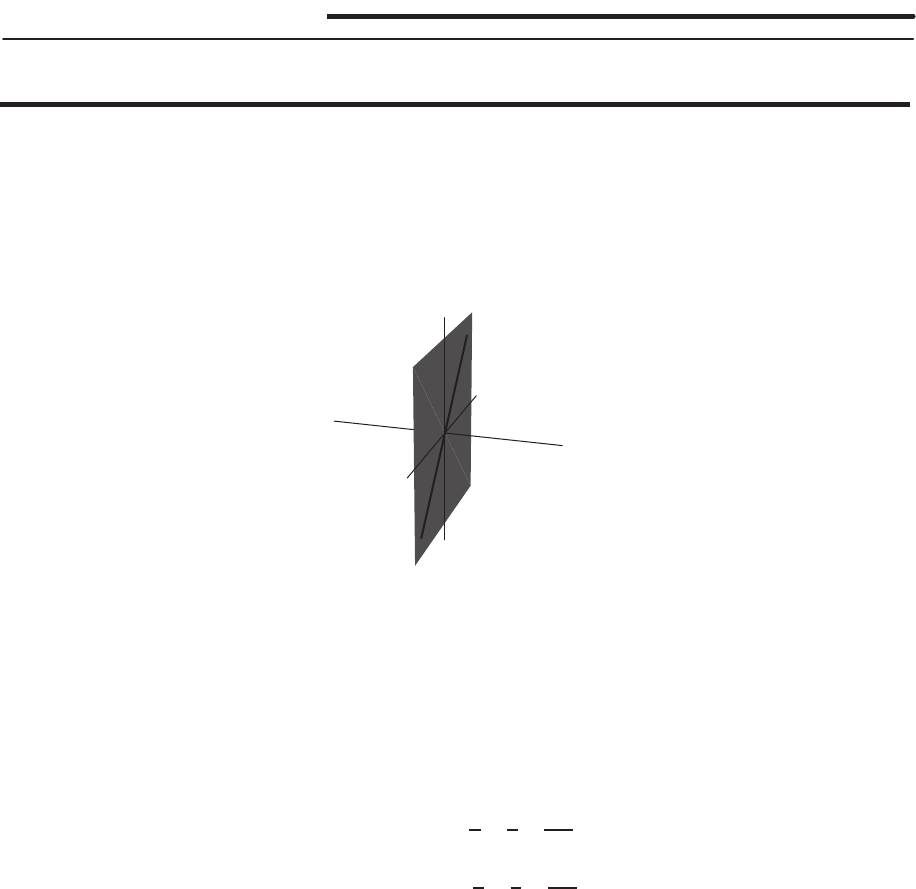
1192 Chapter Twelve /SOLUTIONS
Solutions for Chapter 12 Review
Exercises
1. The distance of a point P= (x, y, z)from the yz-plane is |x|, from the xz-plane is |y|, and from the xy-plane is |z|.
So Ais closest to the yz-plane, since it has the smallest x-coordinate in absolute value. Blies on the xz-plane, since its
y-coordinate is 0.Cis farthest from the xy-plane, since it has the largest z-coordinate in absolute value.
2. Your final position is (1,−1,−3). Therefore, you are in front of the yz-plane, to the left of the xz-plane, and below the
xy-plane.
3. An example is the line z=−xin the xz-plane. See Figure 12.121.
x
y
z
Figure 12.121
4. Given (x, y)we can solve uniquely for z, namely z= 5 −3x+ 2y. Thus, zis a function of xand y:
z=f(x, y) = 5 −3x+ 2y.
5. The equation x2+y2+z2= 100 does not determine zuniquely from xand y. For example, the points (0,0,10) and
(0,0,−10) both satisfy the equation. Therefore zis not a function of (x, y).
6. Given (x, y)we can solve uniquely for z, namely z= 2 + x
5+y
5−3x2
5+y2. Thus, zis a function of xand y:
z=f(x, y) = 2 + x
5+y
5−3x2
5+y2.
7. Planes perpendicular to the positive y-axis should yield the graphs of upright parabolas f(x, y), which widen as yde-
creases (giving f(x, 2) and f(x, 1)). When y= 0, the parabola flattens out, creating a horizontal line for f(x, 0). The
graphs then turn downward, creating the parabolas f(x, −1) and f(x, −2) which become narrower as ydecreases. So the
graph (IV) bests fits this information.
8. (a) is (IV). The level curves of fand gare lines, with slope of f=−1and slope of g= 1. See Figure 12.122.
(b) is (II). The level curves of fand gare lines, with slope of f=−2/3and slope of g= 2/3. See Figure 12.123.
(c) is (I). The level curves of fare parabolas opening upward; the level curves of gare the shape of ln x, but upside
down and for both positive and negative x-values. See Figure 12.124.
(d) is (III). The level curves of fare hyperbolas centered on the x- or y-axes; the level curves of gare rectangular
hyperbolas in quadrants (I) and (III) or quadrants (II) and (IV). See Figure 12.125.

SOLUTIONS to Review Problems for Chapter Twelve 1193
x
yg=c2
f=c1
Figure 12.122
x
yg=c2
f=c1
Figure 12.123
x
y
✛g=c2
✛f=c1
Figure 12.124
x
✛f=c1
✛g=c2
y
Figure 12.125
9. (a) is (I), because there is a minimum at the origin and the surface slopes steadily upward.
(b) is (IV), because there is a maximum at the origin and the surface slopes increasingly steeply downward as we
move away from the origin.
(c) is (II), because there is a maximum at the origin and the surface slopes steadily downward.
(d) is (III), because there is a minimum at the origin and the surface slopes increasingly fast upward as we move
away from the origin.
10. Contours are lines of the form 3x−5y+ 1 = cas shown in Figure 12.126. Note that for the regions of xand ygiven, the
cvalues range from −12 < c < 12 and are evenly spaced.
−2−1 1 2
−2
−1
1
2
x
y
−12
−8
−4
0
4
8
12
Figure 12.126
11. Since setting z=c, with −1≤c≤1gives y= sin−1c+ 2nπ or y=π−sin−1c+ 2nπ =constant, where nis any
integer, contours are horizontal lines as shown in Figure 12.127.

1194 Chapter Twelve /SOLUTIONS
−2−1 1 2
−2
−1
1
2
x
y
−0.2
0.20.4
−0.4
−0.6
0.6
0.8
−0.8
0.95
0.95
−0.95
−0.95
Figure 12.127
12. Contours are ellipses of the form 2x2+y2=cas shown in Figure 12.128. Note that for the ranges of xand ygiven, the
range of cvalue is 1≤c < 9and are closer together farther from the origin.
−2−1 1 2
−2
−1
1
2
x
y
1
3
5
7
Figure 12.128
13. The contours are ellipses of the form 2x2+y2=−ln cas shown in Figure 12.129. For the ranges of xand ygiven, the
cvalues range from just above 0to 1.
−2−1 1 2
−2
−1
1
2
x
y
0.8
0.5
0.2
0.07
0.01
Figure 12.129
14. These conditions describe a line parallel to the z-axis which passes through the xy-plane at (2,1,0).
15. The equation is (x−1)2+ (y−2)2+ (z−3)2= 25
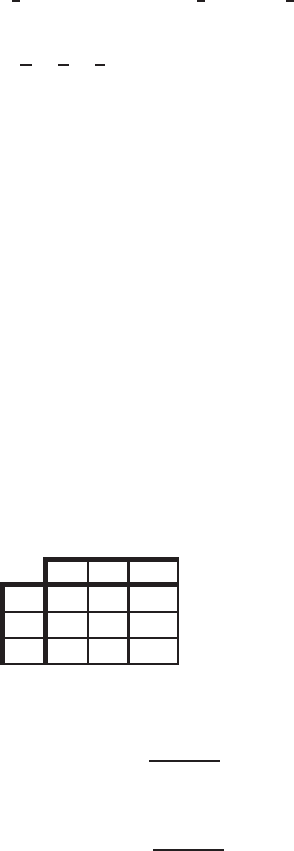
SOLUTIONS to Review Problems for Chapter Twelve 1195
16. The equation will be of the form mx +ny +ez =d, but you can divide through by dto get an equation of the form
ax +by +cz = 1 (dcan not be zero, as the origin is not in the plane). Now plug in the points: From (0,0,2), we get
a(0) + b(0) + c(2) = 1. From this we get c=1
2. Similarly we get a=1
5, and b=1
3. So the equation that fits these
points is
x
5+y
3+z
2= 1.
The equation of this plane can also be obtained by calculating the normal as the cross product of two vectors lying in the
plane.
17. We complete the square
x2+ 4x+y2−6y+z2+ 12z= 0
x2+ 4x+ 4 + y2−6y+ 9 + z2+ 12z+ 36 = 4 + 9 + 36
(x+ 2)2+ (y−3)2+ (z+ 6)2= 49
The center is (−2,3,−6) and the radius is 7.
18. A contour diagram is linear if the contours are parallel straight lines, equally spaced for equally spaced values of z. This
contour diagram does not represent a linear function.
19. A contour diagram is linear if the contours are parallel straight lines, equally spaced for equally spaced values of z. This
contour diagram could represent a linear function.
20. (a) Since the function is linear, the increment between successive entries in the same column is constant. From the third
column we see that the increment is 2−8 = −6. Subtract 6 to go from any entry in the table to the entry below it,
and add 6 to get the entry above it. See Table 12.17.
Table 12.17
x
y
2.5 3.0 3.50
−16 7 8
1 0 1 2
3−6−5−4
(b) From the third column of the table we calculate
Slope in x-direction =m=2−8
1−(−1) =−3.
From the first row of the table we calculate
Slope in y-direction =n=8−6
3.5−2.5= 2.
The equation of the linear function is
f(x, y) = z0+m(x−x0) + n(y−y0)
=f(−1,2.5) −3(x−(−1)) + 2(y−2.5) = −2−3x+ 2y.
21. The level surfaces appear to be circular cylinders centered on the z-axis. Since they don’t change with z, there is no zin
the formula, and we can use the formula for a circle in the xy-plane, x2+y2=r2.Thus the level surfaces are of the
form f(x, y, z) = x2+y2=cfor c > 0.
22. The paraboloid is z=x2+y2+ 5, so it is represented by
z=f(x, y) = x2+y2+ 5
and
g(x, y, z) = x2+y2+ 5 −z= 0.
Other answers are possible.
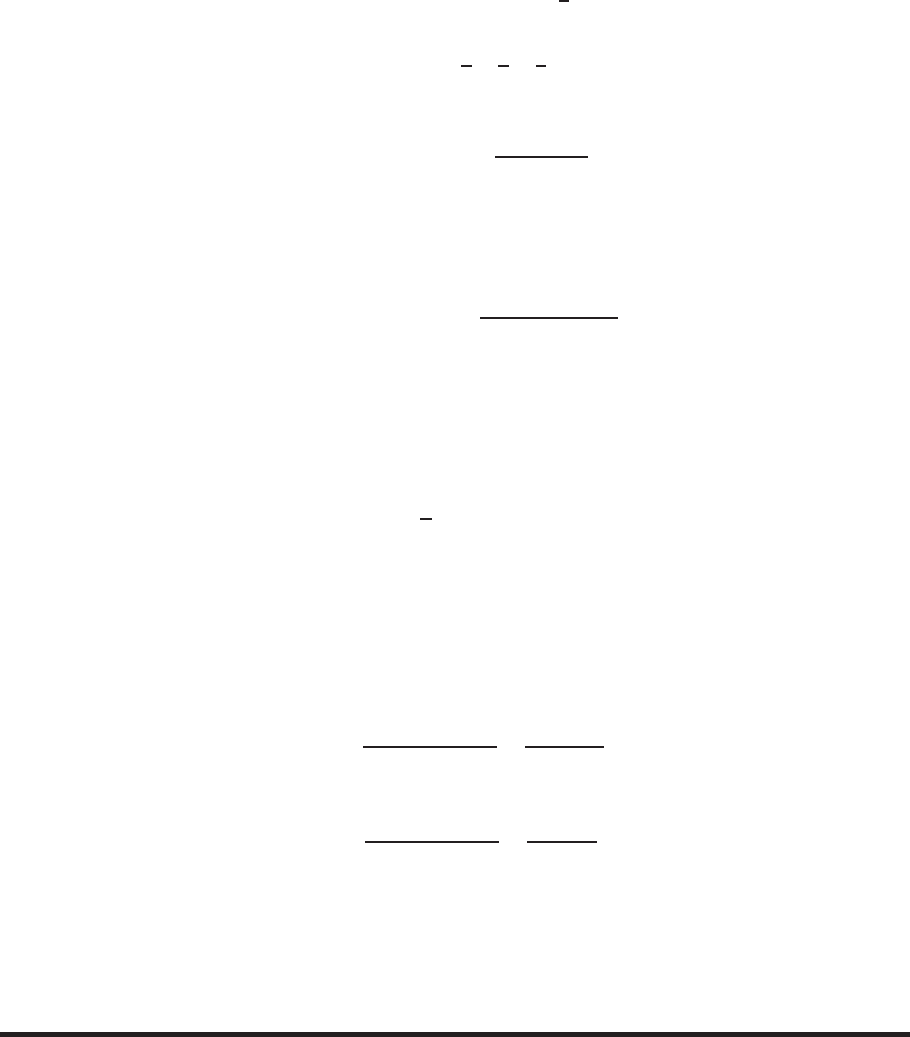
1196 Chapter Twelve /SOLUTIONS
23. Plane is (x/2) + (y/3) + (z/4) = 1, so it is represented by
z=f(x, y) = 4 −2x−4
3y
and
g(x, y, z) = x
2+y
3+z
4= 1.
Other answers are possible.
24. The upper half of the sphere is represented by
z=f(x, y) = p1−x2−y2
and
g(x, y, z) = x2+y2+z2= 1.
Other answers are possible.
25. The sphere is (x−3)2+y2+z2= 4, so the lower half is represented by
z=f(x, y) = −p4−(x−3)2−y2
and
g(x, y, z) = (x−3)2+y2+z2= 4.
Other answers are possible.
26. The level surfaces have equation cos(x+y+z) = c. For each value of cbetween −1and 1, the level surface is an infinite
family of planes parallel to x+y+z= arccos(c). For example, the level surface cos(x+y+z) = 0 is the family of
planes
x+y+z=π
2±2nπ, n = 0,1,2,....
27. A cylindrical surface.
28. A cone.
29. (a) The contours of gare parallel straight lines, and equally spaced function values correspond to equally spaced contours.
These are the characteristics of the contour diagram of a linear function.
(b) The zero contour goes through the origin, so g(0,0) = 0 is one value of the function.
The slope min the x-direction, obtained from the function values at (0,0) and (50,0), is
m=g(50,0) −g(0,0)
50 −0=10000 −0
50 −0= 200.
The slope nin the y-direction, obtained from the function values at (0,0) and (0,50), is
n=g(0,50) −g(0,0)
50 −0=5000 −0
50 −0= 100.
We have the formula
g(x, y) = z0+m(x−x0) + n(y−y0)
=g(0,0) + m(x−0) + n(y−0) = 200x+ 100y.
Problems
30. The cross-sections perpendicular to the t-axis are sine curves of the form g(x, b) = (cos b) sin 2x; these have period π.
The cross-sections perpendicular to the x-axis are cosine curves of the form g(a, t) = (sin 2a) cos t; these have period
2π.
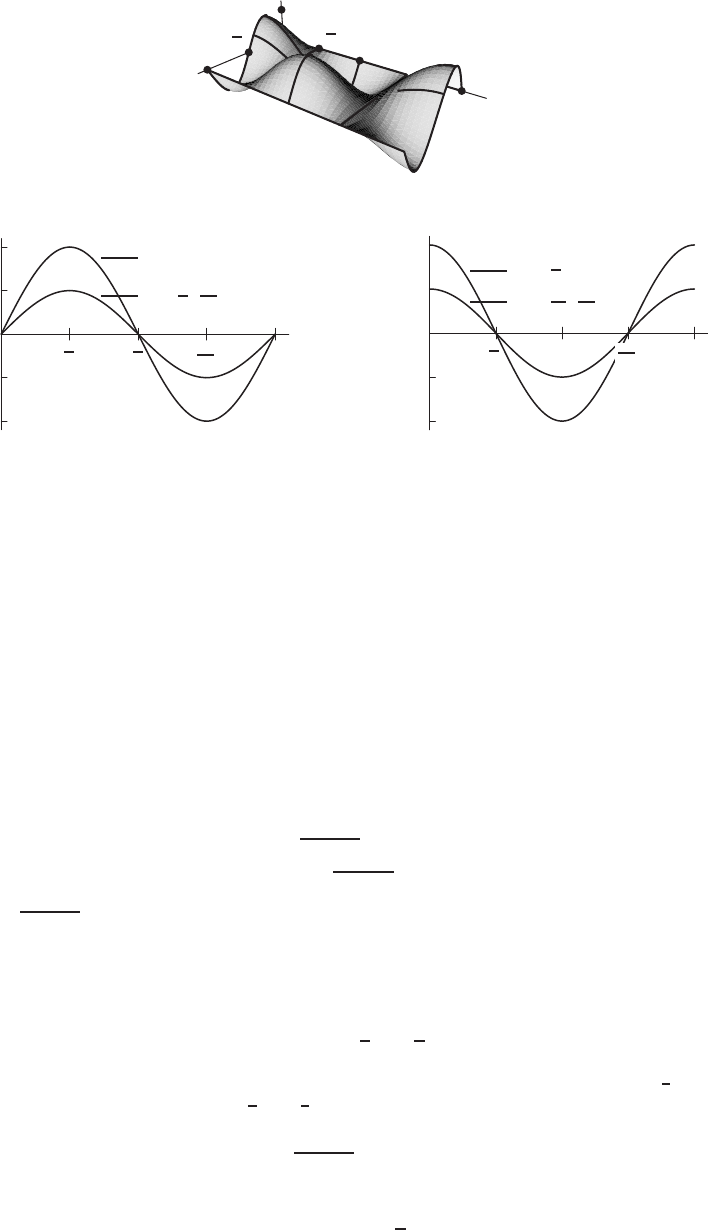
SOLUTIONS to Review Problems for Chapter Twelve 1197
x
t
g(x, t)
1
π
2π
2π
π
π
2
Figure 12.130
: Graph g(x, t) = cos tsin 2x
π
4
π
23π
4
π
−1
−0.5
0
0.5
1✛t= 0,2π
✛t=π
3,5π
3
x
Figure 12.131
: Cross-section
g(x, b) = (cos b) sin 2x,
with b= 0,π/3,5π/3,2π
π
2π3π
22π
−1
−0.5
0
0.5
1✛x=π
4
✛x=π
12 ,5π
12
t
Figure 12.132
: Cross-section
g(a, t) = (sin 2a) cos t
with a=π/12,π/4,5π/12
31. If
P0=f(L0, K0) = 1.01L0.75
0K0.25
0
then replacing L0and K0by 2L0and 2K0gives
f(2L0,2K0) = 1.01(2L0)0.75(2K0)0.25
= 20.7520.25 ·1.01L0.75
0K0.25
0
= 2f(L0, K0)
= 2P0.
So, doubling labor and capital doubles production.
32. (a) The level curve f= 1 is given by
px2+y2+x= 1
px2+y2= 1 −x.
Since px2+y2≥0, we must have x≤1. Squaring gives
x2+y2= (1 −x)2= 1 −2x+x2
So the level curve is given by
x=−1
2y2+1
2
with x≤1. Looking at the equation for the level curve, xalways satisfies x≤1since x≤1
2. This means the
level curve f= 1 is the parabola x=−1
2y2+1
2. See Figure 12.133.
Similarly, the level curve f= 2 has equation, valid for x≤2,
px2+y2= 2 −x
x2+y2= 4 −4x+x2
x=−1
4y2+ 1

1198 Chapter Twelve /SOLUTIONS
The level curve f= 3 has equation, valid for x≤3,
px2+y2= 3 −x
x2+y2= 9 −6x+x2
x=−1
6y2+3
2.
Both f= 2 and f= 3 are valid for all xand ysatisfying the respective equations, so the level curves are parabolas.
See Figure 12.133.
(b) The level curve f=chas equation, valid for x≤c,
px2+y2=c−x
x2+y2=c2−2cx +x2
x=−1
2cy2+c
2.
If c > 0, then any xsatisfying this equation satisfies x≤c
2, so we have x < c. Thus, the level curve exists for c > 0.
If c < 0, then any xsatisfying the level curve equation also satisfies x≥c
2, so x > c (since cis negative). Thus, the
level curves do not exist for c < 0. If c= 0, we get the level curve y= 0 with x≤0. Summarizing, we have that
level curves exist only for c≥0.
x
y
f=c
Figure 12.133
33. (a) You can see the sequence of values 1, 2, 3, 4, 5, 6, ...as you follow diagonal paths in the table upward to the right,
changing to the next lower diagonal after reaching the top x= 1 row. The pattern continues in the same way, giving
Table 12.18
Table 12.18
x
y
123456
1 1 3 6 10 15 21
2 2 ր5ր9ր14 ր20 ր27
3 4 ր8ր13 ր19 ր26 ր34
4 7 ր12 ր18 ր25 ր33 ր42
5 11 ր17 ր24 ր32 ր41 ր51
6 16 ր23 ր31 ր40 ր50 ր61
(b) It appears that the value of fincreases by 1 whenever xis decreased by 1 and yis increased by 1. To check this,
compute
f(x−1, y + 1) = (1/2)((x−1) + (y+ 1) −2)((x−1) + (y+ 1) −1) + (y+ 1)
= (1/2)(x+y−2)(x+y−1) + y+ 1
=f(x, y) + 1

SOLUTIONS to Review Problems for Chapter Twelve 1199
It appears that the value of fincreases by 1 when moving from a point (1, y)to the point (y+ 1,1). To check
this, compute
f(y+ 1,1) = (1/2)((y+ 1) + 1 −2)((y+ 1) + 1 −1) + 1
=1
2y2+1
2y+ 1
= (1/2)(1 + y−2)(1 + y−1) + y+ 1
=f(1, y) + 1
34. Let us suppose that (x, y)approaches (0,0) along the line y=x. Then
f(x, y) = f(x, x) = x3
x4+x2=x
x2+ 1 .
Therefore
lim
(x,y)→(0,0)
y=x
f(x, y) = lim
x→0
x
x2+ 1 = 0.
On the other hand, if (x, y)approaches (0,0) along the parabola y=x2we have
f(x, y) = f(x, x2) = x4
2x4=1
2
and
lim
(x,y)→(0,0)
y=x2
f(x, y) = lim
x→0f(x, x2) = 1
2.
Thus no matter how close they are to the origin, there will be points (x, y)such that f(x, y)is close to 0and points (x, y)
such that f(x, y)is close to 1
2. So the limit
lim
(x,y)→(0,0) f(x, y)
does not exist.
35. Points along the positive x-axis are of the form (x, 0); at these points the function looks like x/2x= 1/2everywhere
(except at the origin, where it is undefined). On the other hand, along the y-axis, the function looks like y2/y =y, which
approaches 0 as we get closer to the origin. Since approaching the origin along two different paths yields numbers that
are not the same, the limit does not exist.
36. We will study the continuity of fat (a, 0). Now f(a, 0) = 1 −a. In addition:
lim
(x,y)→(a,0)
y>0
f(x, y) = lim
x→a(1 −x) = 1 −a
lim
(x,y)→(a,0)
y<0
f(x, y) = lim
x→a−2 = −2.
If a= 3, then
lim
(x,y)→(3,0)
y>0
f(x, y) = 1 −3 = −2 = lim
(x,y)→(3,0)
y<0
f(x, y)
and so lim(x,y)→(3,0) f(x, y) = −2 = f(3,0).Therefore fis continuous at (3,0).
On the other hand, if a6= 3, then
lim
(x,y)→(a,0)
y>0
f(x, y) = 1 −a6=−2 = lim
(x,y)→(a,0)
y<0
f(x, y)
so lim(x,y)→(a,0) f(x, y)does not exist. Thus fis not continuous at (a, 0) if a6= 3.
Thus, fis not continuous along the line y= 0. (In fact the only point on this line where fis continuous is the point
(3,0).)
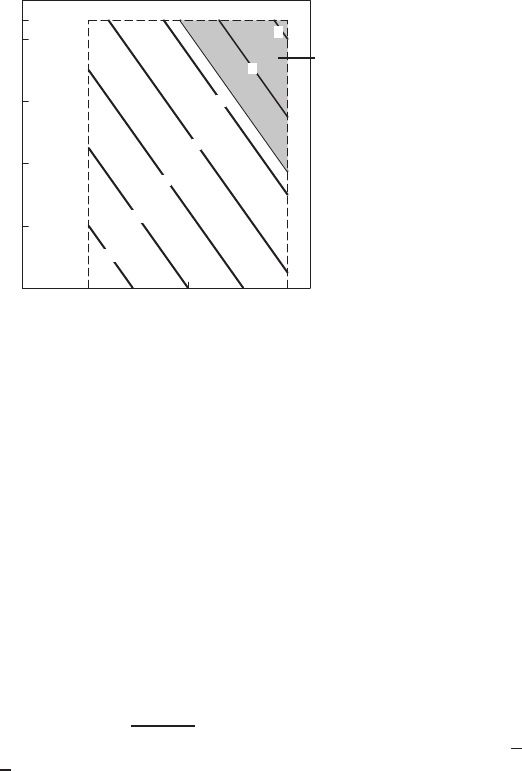
1200 Chapter Twelve /SOLUTIONS
37. (a) A student with SATs of 1050 and a GPA of 3.0has a z-value given by
z= 0.003 ·1050 + 0.8·3.0−4 = 1.55
Since 1.55 <2.3, this student will not be admitted.
(b) A student with SATs of 1600 and GPA of yhas a z-value given by
z= 0.003 ·1600 + 0.8y−4 = 0.8 + 0.8y= 0.8(y+ 1)
Since 0.8(y+1) may be greater than or less than 2.3, not all of the students with SAT scores of 1600 will be admitted.
(c) A student with GPA of 4.3and SATs of xhas a z-value given by
z= 0.003x+ 0.8·4.3−4 = 0.003x−0.56
Since 0.003x−0.56 may be greater than or less than 2.3, not all of the students with a high school GPA of 4.3 will
be admitted.
(d) See Figure 12.134.
400 1000 1600
0
1
2
3
4
4.3
x
y
−2
−1
0
1
2
3
4
✛
Admission area
Figure 12.134
(e) If ∆x= 100, then ∆z= 0.003∆x= 0.003 ·100 = 0.3.
If ∆y= 0.5, then ∆z= 0.8·0.5 = 0.4.
An extra 0.5of high school GPA increases a student’s z-value by more than an extra 100 points on the SAT. Thus,
the increase in GPA is more important.
38. (a) The plane y= 1 intersects the graph in the parabola z= (x2+ 1) sin(1) + x=x2sin(1) + x+ sin(1). Since sin(1)
is a constant, z=x2sin(1) + x+ sin(1) is a quadratic function whose graph is a parabola.
Any plane of the form y=awill do as long as ais not a multiple of π.
(b) The plane y=πintersects the graph in the straight line z=π2x. (Since sin π= 0, the equation becomes linear,
z=π2xif y=π.)
(c) The plane x= 0 intersects the graph in the curve z= sin y.
39. (a) To find the level curves, we let Tbe a constant.
T= 100 −x2−y2
x2+y2= 100 −T,
which is an equation for a circle of radius √100 −Tcentered at the origin. At T= 100◦, we have a circle of radius
0 (a point). At T= 75◦, we have a circle of radius 5. At T= 50◦, we have a circle of radius 5√2. At T= 25◦, we
have a circle of radius 5√3. At T= 0◦, we have a circle of radius 10.
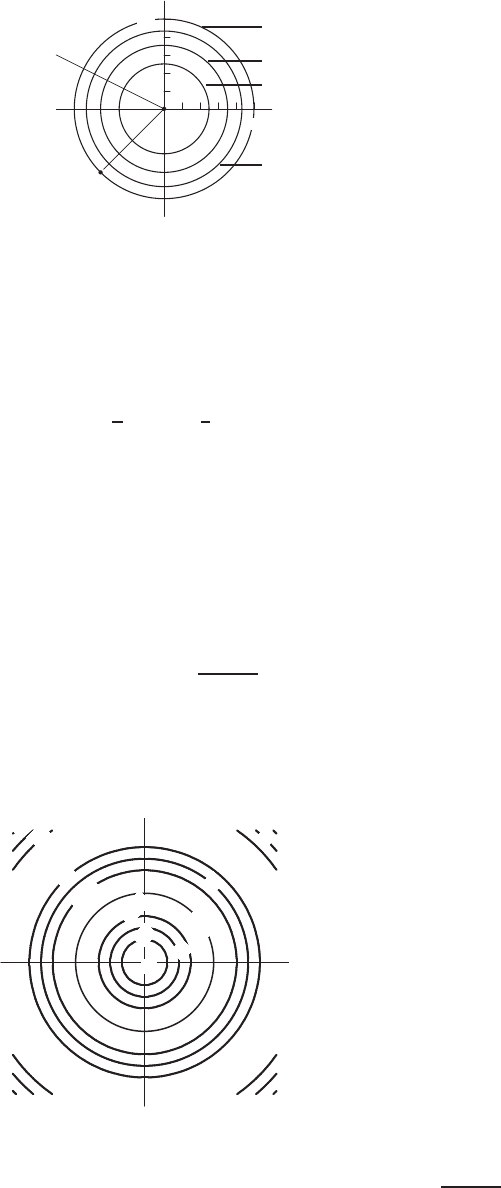
SOLUTIONS to Review Problems for Chapter Twelve 1201
10
10
x
y
T= 0
T= 50
T= 75
T= 25
Motion of bug
✛
✛
✛
✛
✒
✒
✒
✒
T= 100
❥
Figure 12.135
(b) No matter where we put the bug, it should go straight toward the origin—the hottest point on the xy-plane. Its
direction of motion is perpendicular to the tangent lines of the level curves, as can be seen in Figure 12.135.
40. Let the equation of the plane be z=ax +by +c. When z= 0, the line on the xy-plane is ax +by +c= 0. Since we
know that the plane intersects the xy-plane along the line y= 2x+ 2 we have b6= 0 and
−a
b= 2 −c
b= 2
Since (1,2,2) lies on the plane, we can use the equation z=ax +by +cto get
2 = a+ 2b+c
Solving the equations gives
a= 2,
b=−1,
c= 2.
Hence z= 2x−y+ 2 and the linear function is f(x, y) = 2x−y+ 2.
41. (a) Since z=c, where −1≤c≤1is a constant, gives px2+y2=±cos−1(c) + 2kπ, where kis any integer
such that ±cos−1(c) + 2kπ is non-negative, or x2+y2=r2, where r=±cos−1(c) + 2kπ, which represents
a family of circles of radius rcentered at (0,0), the level curves of the function are families of circles, as shown in
Figure 12.136.
x
y
1
.5
0
−.5
−1
−.5
0
.5
.5
0
−.5
Figure 12.136
(b) The plane containing the x- and z-axes is the plane y= 0. Thus the cross-section is z= cos √x2+ 02= cos(|x|) =
cos x, as shown in Figure 12.137.
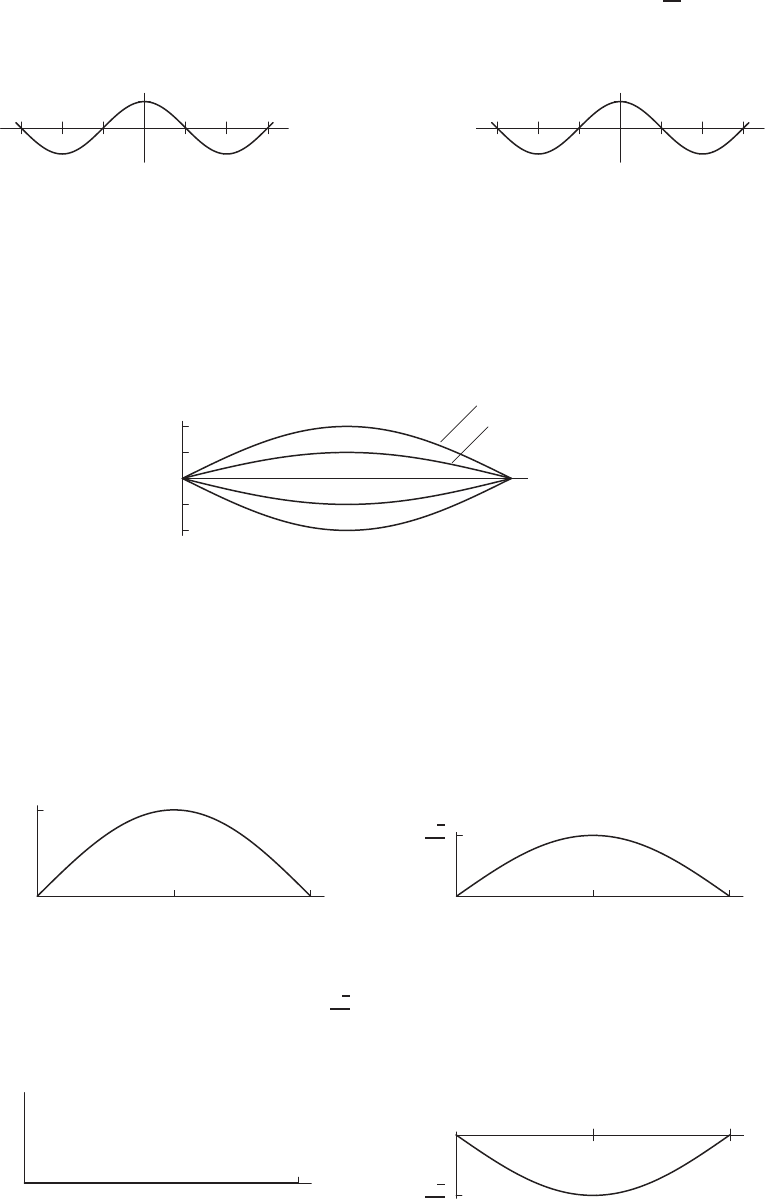
1202 Chapter Twelve /SOLUTIONS
(c) Denote the line y=xin the xy-plane as r-axis and put units on it such that the units on the r-axis coincide with the
units on the x-axis and y-axis, namely, r2=x2+y2. Thus, the cross-section is z= cos √r2= cos(|r|) = cos r,
as shown in Figure 12.138.
−ππ
1
x
z
Figure 12.137
−ππ
1
r
z
Figure 12.138
42. The function y=f(x, 0) = cos 0 sin x= sin xgives the displacement of each point of the string when time is held fixed
at t= 0. The function f(x, 1) = cos 1 sin x= 0.54 sin xgives the displacement of each point of the string at time t= 1.
Graphing f(x, 0) and f(x, 1) gives in each case an arch of the sine curve, the first with amplitude 1and the second with
amplitude 0.54. For each different fixed value of t, we get a different snapshot of the string, each one a sine curve with
amplitude given by the value of cos t. The result looks like the sequence of snapshots shown in Figure 12.139.
π
−1
−0.54
0.54
1
x
y
✠
f(x, 0) = sin x
✠
f(x, 1) = 0.54 sin x
Figure 12.139
43. The function f(0, t) = cos tsin 0 = 0 gives the displacement of the left end of the string as time varies. Since that point
remains stationary, the displacement is zero. The function f(1, t) = cos tsin 1 = 0.84 cos tgives the displacement of the
point at x= 1 as time varies. Since cos toscillates back and forth between 1and −1, this point moves back and forth with
maximum displacement of 0.84 in either direction. Notice the maximum displacements are greatest at x=π/2where
sin x= 1.
44. (a) For t= 0, we have y=f(x, 0) = sin x,0≤x≤π, as in Figure 12.140.
π/2π
1
x
y
Figure 12.140
π/2π
√2
2
x
y
Figure 12.141
For t=π/4, we have y=f(x, π/4) = √2
2sin x,0≤x≤π, as in Figure 12.141.
For t=π/2, we have y=f(x, π/2) = 0, as in Figure 12.142.
πx
y
Figure 12.142
π/2π
−√2
2
x
y
Figure 12.143
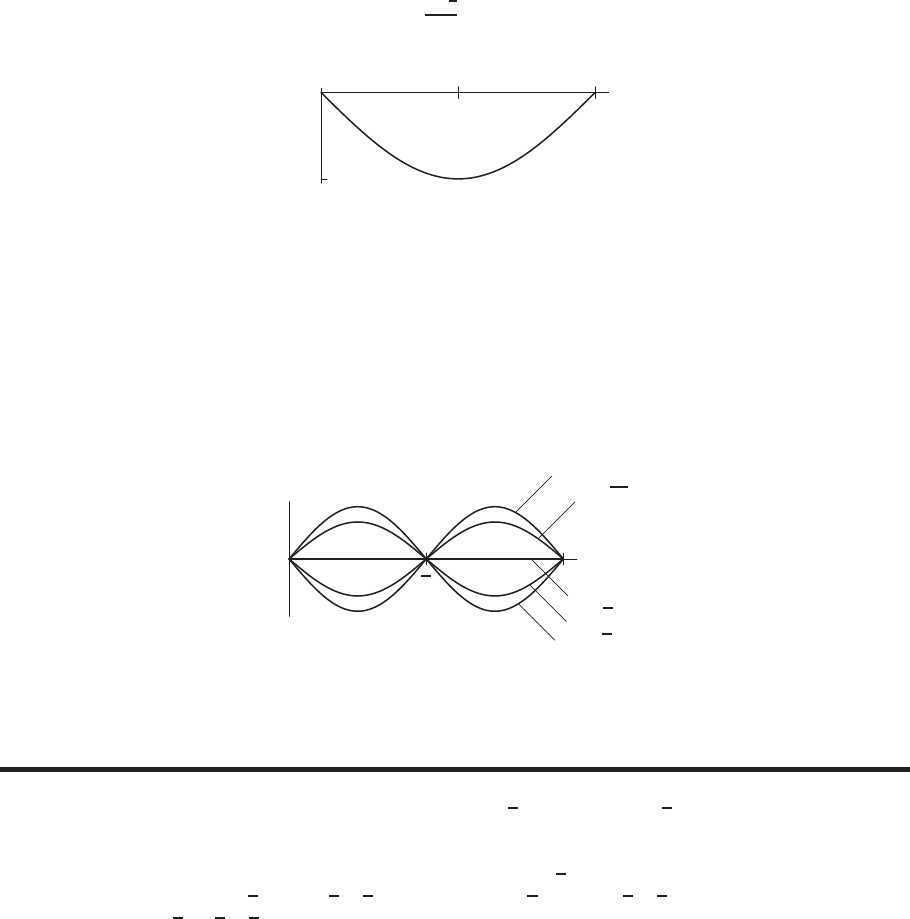
SOLUTIONS to Review Problems for Chapter Twelve 1203
For t= 3π/4, we have y=f(x, 3π/4) = −√2
2sin x,0≤x≤π, as in Figure 12.143.
For t=π, we have y=f(x, π) = −sin x,0≤x≤π, as in Figure 12.144.
π/2πx
−1
y
Figure 12.144
(b) The graphs show an arch of a sine wave which is above the x-axis, concave down at t= 0, is straight along the x-axis
at t=π/2, and below the x-axis, concave up at t=π, like a guitar string vibrating up and down.
45. (a) For g(x, t) = cos 2tsin x, our snapshots for fixed values of tare still one arch of the sine curve. The amplitudes,
which are governed by the cos 2tfactor, now change twice as fast as before. That is, the string is vibrating twice as
fast.
(b) For y=h(x, t) = cos tsin 2x, the vibration of the string is more complicated. If we hold tfixed at any value, the
snapshot now shows one full period, i.e. one crest and one trough, of the sine curve. The magnitude of the sine curve
is time dependent, given by cos t. Now the center of the string, x=π/2, remains stationary just like the end points.
This is a vibrating string with the center held fixed, as shown in Figure 12.145.
π
2πx
y
✠
t=π
✠
t=3π
4
■
t= 0
■
t=π
4
■
t=π
2
Figure 12.145
: Another vibrating string: y=h(x, t) = cos tsin 2x
CAS Challenge Problems
46. (a) Let C= (x, y, 0). Since distance AC = 2 we have x2+y2= 22, and since distance BC = 2 we have (x−2)2+
y2= 22. Solving these two equations, we have C= (1,√3,0) or C= (1,−√3,0). We will pick the first choice
(the second choice gives different answers in the next part).
(b) Let D= (x, y, z). Distance DA = 2 implies that x2+y2+z2= 4. Distance DB = 2 implies that (x−2)2+
y2+z2= 4 . Distance DC = 2 implies that (x−1)2+ (y−√3)2+z2= 4. Solving these three equations, we
have: x= 1,y= 1/√3,z= 2√2/√3or x= 1,y= 1/√3,z=−2√2/√3. Picking the first choice we have
D= (1,1/√3,2√2/√3).
(c) The figure is a tetrahedron, that is, a polyhedron with four faces, each of which is an equilateral triangle: ABC,
ABD,ACD,BCD.
47. (a)
f(x, f(x, y)) = 3 + x+ 2(3 + x+ 2y) = (3 + 2 ·3) + (1 + 2)x+ 22y= 9 + 3x+ 4y
f(x, f(x, f(x, y))) = 3 + x+ 2(3 + x+ 2(3 + x+ 2y))
= (3 + 2 ·3 + 22·3) + (1 + 2 + 22)x+ 23y= 21 + 7x+ 8y
(b) From part (a) we guess that the general pattern for knested fs is
(3 + 2 ·3 + 22·3 + ···+ 2k−1·3) + (1 + 2 + 22+··· + 2k−1)x+ 2ky
Thus
f(x, f(x, f(x, f(x, f(x, f(x, y)))))) =
(3 + 2 ·3 + 22·3 + ···+ 25·3) + (1 + 2 + 22+·· · + 25)x+ 26y= 189 + 63x+ 64y.
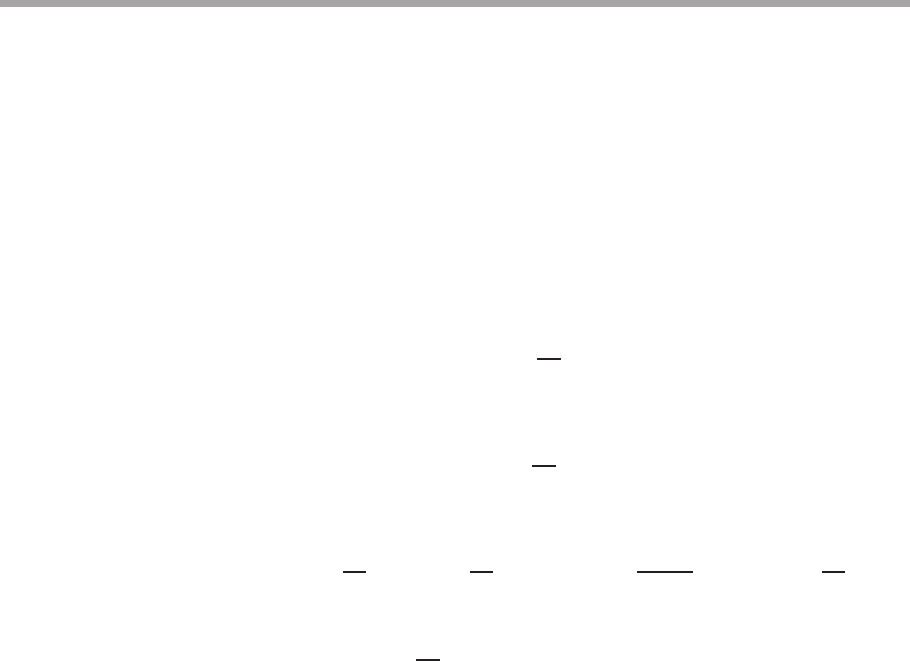
1204 Chapter Twelve /SOLUTIONS
48. (a) Since f(1,1,1) = 16, f(1,1,2) = 21, an increase of 1 in zincreases the value of fby 5. Thus we estimate
f(1,1,3) ≈21 + 5 = 26. Similarly, since f(1,0,1) = 20, f(1,1,1) = 16, an increase of 1 in ydecreases the value
of fby 4. So we estimate f(1,2,1) ≈16 −4 = 12.
(b) When xand yare fixed at 1, fis a linear function of z, thus the linear approximation will give a precise answer for
f(1,1,3). However, when xand zare fixed at 1, fis the sum of an exponential function of yand a linear function,
thus the linear approximation will not be accurate for f(1,2,1).
(c) Since f(x, y, z) = ax2+byz +czx3+d2x−yand f(1,0,1) = 20,f(1,1,1) = 16,f(1,1,2) = 21,f(0,0,1) = 6,
we have
a+c+ 2d= 20
a+b+c+d= 16
a+ 2b+ 2c+d= 21
d= 6
Solving for a, b, c, d, we get f(x, y, z) = 5x2+ 2yz + 3zx3+ 6 ·2x−y.
(d) f(1,1,3) = 26, which matches the estimate in part (a). f(1,2,1) = 15, which does not agree with the estimate in
part (a).
PROJECTS FOR CHAPTER TWELVE
1. (a) The Leq is greatest near the runways. The largest contour marked is 72 dB; Heathrow’s two main runways
are located within this contour and run east-west. The noise level on the runways exceeds 72 dB. For
comparison, the noise level 50 feet from the edge of a freeway in mid-morning is about 76 dB.
(b) Since the prevailing wind is from the west, the planes take off towards the west and land coming in
from the east, which explains why the contours are aligned east-west. Many of the planes taking off want
eventually to go east, so they turn off to the southwest to start a U-turn back to the east. A limited number,
particularly those heading for transatlantic flights, turn right; fewer still head due west on a straight-out
departure. When planes are approaching or departing, they have to use considerable power at low altitude,
and hence are significantly noisier; this noise is concentrated at the end of the runways.
(c) The noise level falls off rapidly to the north and south of the runways. This is reflected in the fact that the
contours are very close together along the length of both runways.
(d) Suppose the decibel measure of the sound, B1, on one contour is given by
B1= 10 log10 L1
L0
and the decibel measure of the sound on the next higher contour, B2, is
B2= 10 log10 L2
L0.
Since contours are labeled at 3 dB intervals,
3 = B2−B1= 10 log10 L2
L0−log10 L1
L0=10 log10 L2/L0
L1/L0=10 log10 L2
L1.
Solving for L2/L1gives
L2
L1
= 103/10 ≈2.
Thus, moving from one contour to the next at 3 dB higher corresponds to approximately doubling the
sound intensity.
(e) We have shown that an increase of 3 dB corresponds approximately to doubling the sound intensity, so a
decrease of 3 dB corresponds approximately to halving the sound intensity. We are told that the new jets
will make 50% less noise, so sound intensity will be halved. Thus, we will subtract 3 dB from each contour
value; for example, the present 57 dB contour will be labeled as 54 dB.
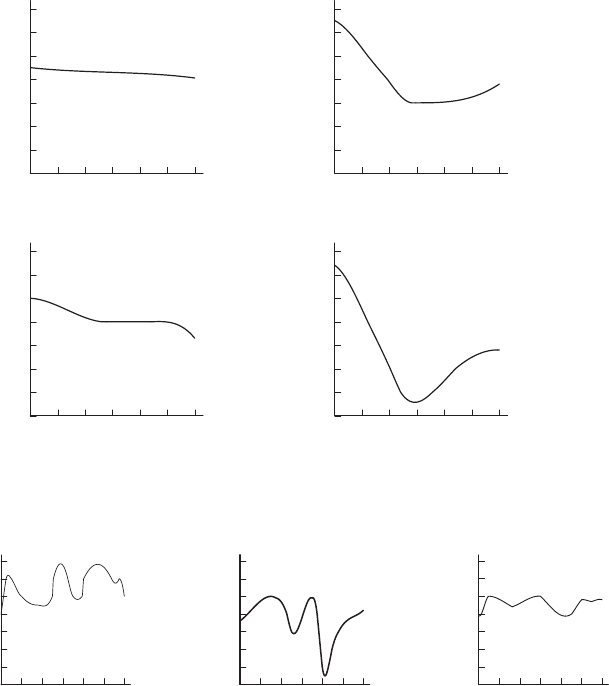
PROJECTS FOR CHAPTER TWELVE 1205
2. (a) About 15 feet along the wall, because that’s where there are regions of cold air (55◦F and 65◦F).
(b) Roughly between 10 am and 12 noon, and between 4 pm and 6 pm.
(c) Roughly between midnight and 2 am, between 10 am and 1 pm, and between 4 pm and 9 pm, since that is
when the temperature near the heater is greater than 80◦F.
(d)
10 20 30
55
65
75
85 6
am
◦
F
ft
10 20 30
55
65
75
85 11
am
◦
F
ft
10 20 30
55
65
75
85 3
pm (
15
hours)
◦F
ft
10 20 30
55
65
75
85 5
pm (
17
hours)
◦
F
ft
Figure 12.146
(e)
8 16 24
55
65
75
85
◦
F
hr
Figure 12.147
:Temp. vs.
Time at heater
8 16 24
55
65
75
85
hr
◦
F
Figure 12.148
:Temp. vs.
Time at window
8 16 24
55
65
75
85
◦
F
hr
Figure 12.149
:Temp. vs.
Time midway between
heater and window
(f) The temperature at the window is colder at 5 pm than at 11 am because the outside temperature is colder
at 5 pm than at 11 am.
(g) The thermostat is set to roughly 70◦F. We know this because the temperature in the room stays close to
70◦F until we get close (a couple of feet) to the window.
(h) We are told that the thermostat is about 2 feet from the window. Thus, the thermostat is either about 13 feet
or about 17 feet from the wall. If the thermostat is set to 70◦F, every time the temperature at the thermostat
goes over or under 70◦F, the heater turns off or on. Look at the point at which the vertical lines at 13 feet
or about 17 feet cross the 70◦F contours. We need to decide which of these crossings correspond best with
the times that the heater turns on and off. (These times can be seen along the wall.) Notice that the 17
foot line does not cross the 70◦F contour after 16 hours (4 pm). Thus, if the thermostat were 17 feet from
the wall, the heater would not turn off after 4 pm. However, the heater does turn off at about 21 hours (9
pm). Since this is the time that the 13 foot line crosses the 70◦F contour, we estimate that the thermostat
is about 13 feet away from the wall.
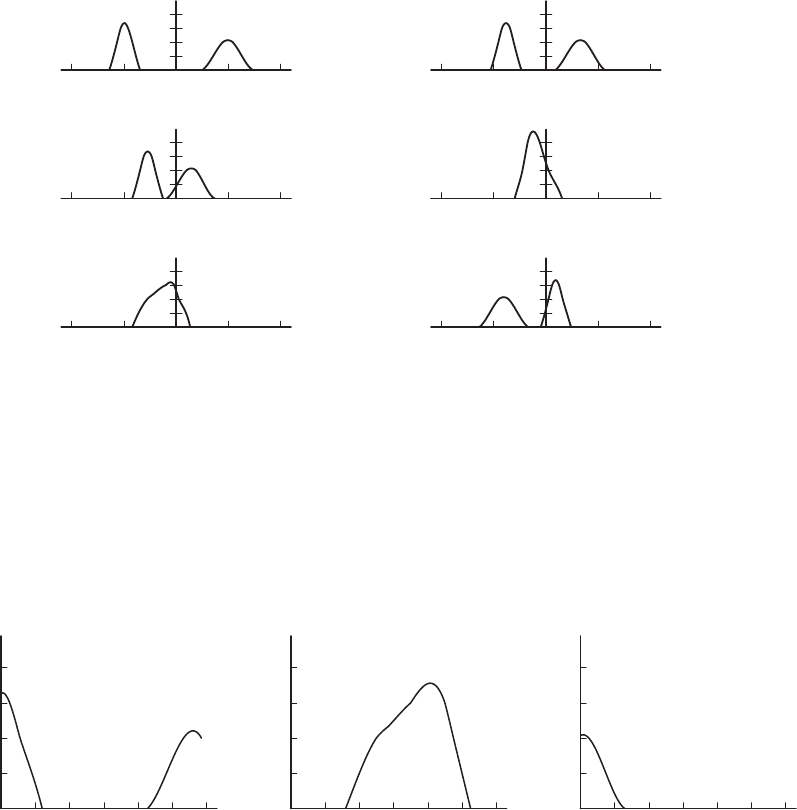
1206 Chapter Twelve /SOLUTIONS
3. (a) Let x=distance (microns) from center of waveguide, t=time (nanoseconds) as shown in the problem,
and I=intensity of light as marked on the given level curves.
−10 −5 0 5 10
0.3
0.6
0.9
1.2
I
x
Time
t= 0
−10 −5 0 5 10
0.3
0.6
0.9
1.2
I
x
Time
t= 2
−10 −5 0 5 10
0.3
0.6
0.9
1.2
I
x
Time
t= 4
−10 −5 0 5 10
0.3
0.6
0.9
1.2
I
x
Time
t= 6
−10 −5 0 5 10
0.3
0.6
0.9
1.2
I
x
Time
t= 8
−10 −5 0 5 10
0.3
0.6
0.9
1.2
I
x
Time
t= 10
Figure 12.150
(b) Two waves would start out at opposite ends of the screen. The wave on the left would be slightly taller
and narrower than the wave on the right. The waves would move toward one another, the wave on the right
moving a little faster. They would meet to the left of the center and appear to merge, becoming taller. They
would then proceed in the directions they were initially going, ultimately leaving the screen on the side
opposite to where they began.
(c) Let x=distance (microns), t=time (nanoseconds), and I=intensity.
2 4 6 8 10 12
0.3
0.6
0.9
1.2
I
t
Location
x=−5
2 4 6 8 10 12
0.3
0.6
0.9
1.2
I
t
Location
x= 0
2 4 6 8 10 12
0.3
0.6
0.9
1.2
I
t
Location
x= 5
Figure 12.151
(d) Two pulses of light are traveling down a wave-guide toward one another. They meet in the center and,
as they pass through one another, appear brighter. They then continue along in the wave-guide in the
directions they were going.

13.1 SOLUTIONS 1207
CHAPTER THIRTEEN
Solutions for Section 13.1
Exercises
1. The vectors are ~a =~
i+ 3~
j,~
b= 3
~
i+ 2~
j,~v =−2
~
i−2~
j, and ~w =−~
i+ 2~
j.
2. ~a = 2
~
i+~
j,
~
b= 2
~
i,
~c =−2
~
i,
~
d=−2
~
i+ 2~
j,
~e =−2
~
i−~
j
3. The vector we want is the displacement from Qto P, which is given by
~
QP = (1 −4)
~
i+ (2 −6)~
j=−3
~
i−4~
j
4. The vector we want is the displacement from Pto Q, which is given by
~
P Q = (4 −1)
~
i+ (6 −2)~
j= 3
~
i+ 4~
j
5. ~a =~
b=~c = 3~
k , ~
d= 2
~
i+ 3~
k , ~e =~
j , ~
f=−2
~
i
6. ~u =~
i+~
j+ 2~
kand ~v =−~
i+ 2~
k.
7. 4
~
i+ 2~
j−3
~
i+~
j=~
i+ 3~
j
8. ~
i+ 2~
j−6
~
i−3~
j=−5
~
i−~
j
9. −4
~
i+ 8~
j−0.5
~
i+ 0.5~
k=−4.5
~
i+ 8~
j+ 0.5~
k
10. (0.9
~
i−1.8~
j−0.02~
k)−(0.6
~
i−0.05~
k) = 0.3
~
i−1.8~
j+ 0.03~
k
11. 3
~
i−4~
j+ 2~
k−6
~
i−8~
j+~
k=−3
~
i−12~
j+ 3~
k
12. 4
~
i−3~
j+ 7~
k−10
~
i−2~
j+ 4~
k=−6
~
i−5~
j+ 11~
k
13. 0.6
~
i+ 0.2~
j−~
k+ 0.3
~
i+ 0.3~
k= 0.9
~
i+ 0.2~
j−0.7~
k
14. ~
i−1
2~
j+3
2~
k+ 3
~
i−1
2~
j+3
2~
k= 4
~
i−~
j+ 3~
k
15. k~v k=p12+ (−1)2+ 22=√6.
16. The length is given by
k~z k=p(1)2+ (−3)2+ (−1)2=√1 + 9 + 1 = √11.
17. k~v k=p12+ (−1)2+ 32=√11.
18. k~v k=p7.22+ (−1.5)2+ 2.12=√58.5≈7.6.
19. k~v k=p1.22+ (−3.6)2+ 4.12=√31.21 ≈5.6.
20. 4~z = 4(
~
i−3~
j−~
k) = 4
~
i−12~
j−4~
k .
21.
5~a + 2~
b= 5(2~
j+~
k) + 2(−3
~
i+ 5~
j+ 4~
k)
= (5(2)~
j+ 5(1)~
k) + (2(−3)
~
i+ 2(5)~
j+ 2(4)~
k)
= (10~
j+ 5~
k) + (−6
~
i+ 10~
j+ 8~
k) = (0 −6)
~
i+ (10 + 10)~
j+ (5 + 8)~
k
=−6
~
i+ 20~
j+ 13~
k .
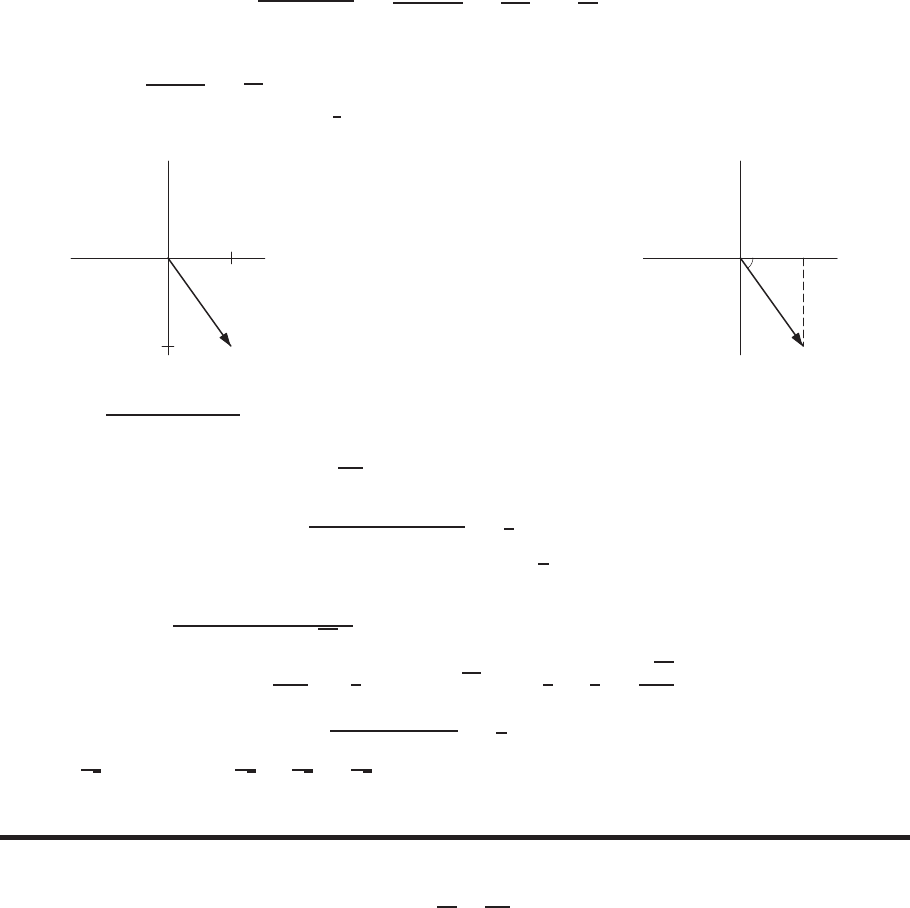
1208 Chapter Thirteen /SOLUTIONS
22. ~a +~z = (2~
j+~
k) + (
~
i−3~
j−~
k) = (0 + 1)
~
i+ (2 −3)~
j+ (1 −1)~
k=~
i−~
j
23. 2~c +~x = 2(
~
i+ 6~
j) + (−2
~
i+ 9~
j) = (2
~
i+ 12~
j) + (−2
~
i+ 9~
j) = (2 −2)
~
i+ (12 + 9)~
j= 21~
j .
24.
2~a + 7~
b−5~z = 2(2~
j+~
k) + 7(−3
~
i+ 5~
j+ 4~
k)−5(
~
i−3~
j−~
k)
= (4~
j+ 2~
k) + (−21
~
i+ 35~
j+ 28~
k)−(5
~
i−15~
j−5~
k)
= (−21 −5)
~
i+ (4 + 35 + 15)~
j+ (2 + 28 + 5)~
k=−26
~
i+ 54~
j+ 35~
k .
25.
k~y −~x k=k(4
~
i−7~
j)−(−2
~
i+ 9~
j)k=k(4 −(−2))
~
i+ (−7−9)~
jk=k6
~
i−16~
jk
=p62+ (−16)2=√36 + 256 = √292 = 2√73.
26. (a) See Figure 13.1.
(b) k~v k=√52+ 72=√74 = 8.602.
(c) We see in Figure 13.2 that tan θ=7
5and so θ= 54.46◦.
~v
5
−7
x
y
Figure 13.1
θ
7
5x
y
Figure 13.2
27. Since p(0.06)2+ (0.08)2= 0.1, the vector is
1
0.1(0.06
~
i−0.08~
k) = 0.6
~
i−0.8~
k .
28. To find a vector in the opposite direction to ~v =~
i−~
j+~
k, we can take the scalar multiple (−1)~v =−~
i+~
j−~
k. The
magnitude of the vector (−1)~v is p(−1)2+ 12+ (−1)2=√3. So
(−~
i+~
j−~
k)/√3
is the unit vector in the opposite direction to~
i−~
j+~
k.
29. Since ||~v ||2=p22+ (−1)2+ (−√11)2= 16, we have ||~v || = 4. Thus, the vector we want is
−~v
||~v || =−1
4(2
~
i−~
j−√11~
k) = −1
2~
i+1
4~
j+√11
4~
k .
30. The length of the vector~
i−~
j+2~
kis p12+ (−1)2+ 22=√6. We can scale the vector down to length 2 by multiplying
it by 2
√6. So the answer is 2
√6~
i−2
√6~
j+4
√6~
k.
Problems
31. If two vectors are parallel, they are scalar multiples of one another. Thus
a2
5a=6
−3.
Solving for agives
a2=−2·5aso a= 0,−10.
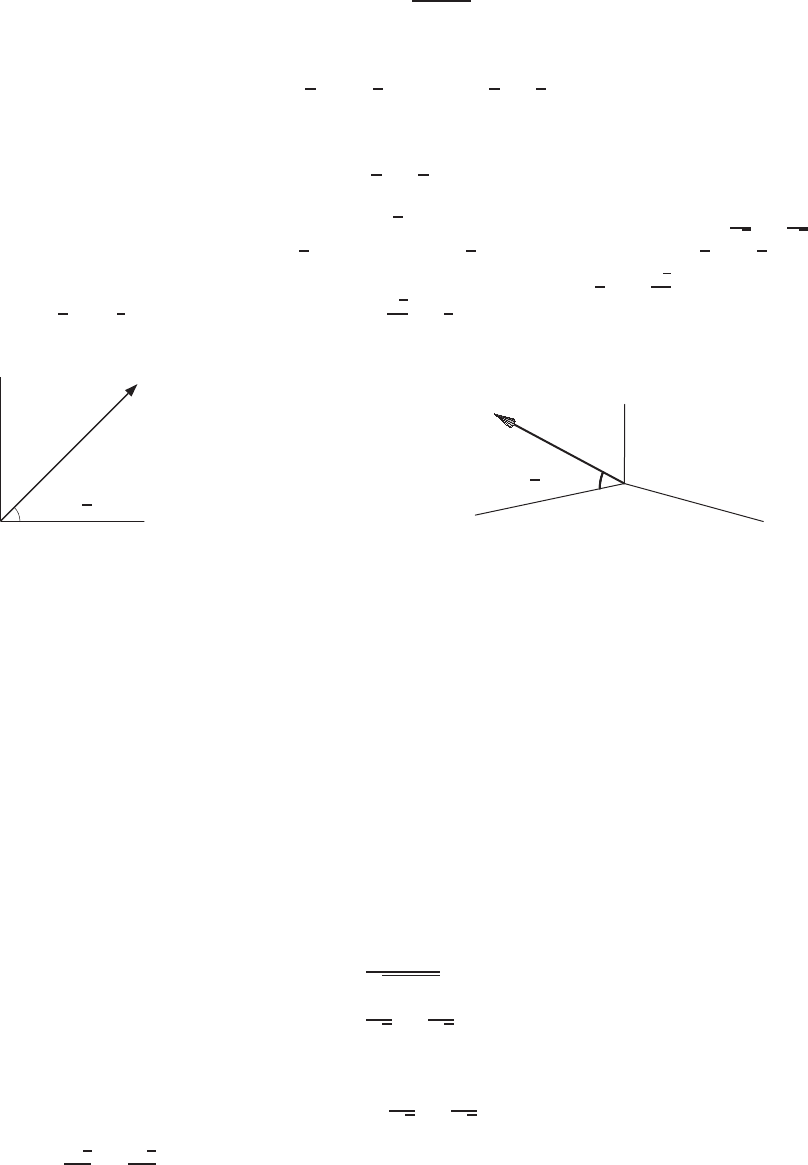
13.1 SOLUTIONS 1209
32. (a) The displacement from Pto Qis given by
−−→
P Q = (4
~
i+ 6~
j)−(
~
i+ 2~
j) = 3
~
i+ 4~
j .
Since
k−−→
P Qk=p32+ 42= 5,
a unit vector ~u in the direction of −−→
P Q is given by
~u =1
5−−→
P Q =1
5(3
~
i+ 4~
j) = 3
5~
i+4
5~
j .
(b) A vector of length 10 pointing in the same direction is given by
10~u = 10( 3
5~
i+4
5~
j) = 6
~
i+ 8~
j .
33. The vector ~v =−~
i+~
jpoints northwest. Since k~v k=√2, the unit vector pointing northwest is ~u =−1
√2~
i+1
√2~
j.
34. (a) The components are v1= 2 cos π/4 = √2, v2= 2 sin π/4 = √2. See Figure 13.3. Thus ~v =√2
~
i+√2~
j.
(b) Since the vector lies in the xz-plane, its y-component is 0. Its x-component is 1 cos( π
6)
~
i=√3
2~
iand its z-component
is 1 sin( π
6)~
j=1
2~
j. See Figure 13.4. So the vector is √3
2~
i+1
2~
k.
x
y
45◦=π
4
Figure 13.3
xy
z
π
6= 30◦
Figure 13.4
35. The coordinates of the points are:
A= (0,0), B = (2,2), C = (7,0), D = (3,4), E = (4,2).
(a) We find −→
AB = 2
~
i+ 2~
j,−−→
CD =−4
~
i+ 4~
j. Therefore,
~u = (2.5)(2
~
i+ 2~
j) + (−0.8)(−4
~
i+ 4~
j) = 5
~
i+ 5~
j+ 3.2
~
i−3.2~
j= 8.2
~
i+ 1.8~
j ,
~v = (2.5)(−2
~
i−2~
j)−(−0.8)(−4
~
i+ 4~
j) = −5
~
i−5~
j−3.2
~
i+ 3.2~
j=−8.2
~
i−1.8~
j .
(b) We see that ~v =−~u . We know that −−→
AB is equivalent to −→
BA. In other words,
~v =−(2.5)−→
AB + (0.8)−−→
CD.
By factoring out a −1, we get
~v =−((2.5)−→
AB + (−0.8)−−→
CD) = −~u .
36. We find −→
EA to be −4
~
i−2~
j. A unit vector on the −→
EA direction is
~n =−4i−2j
√42+ 22
=−2
√5
~
i−1
√5
~
j .
So a vector of length 2 in this direction is
~p = 2~n =−4
√5
~
i−2
√5
~
j .
Thus, ~p =−4√5
5~
i−2√5
5~
j.
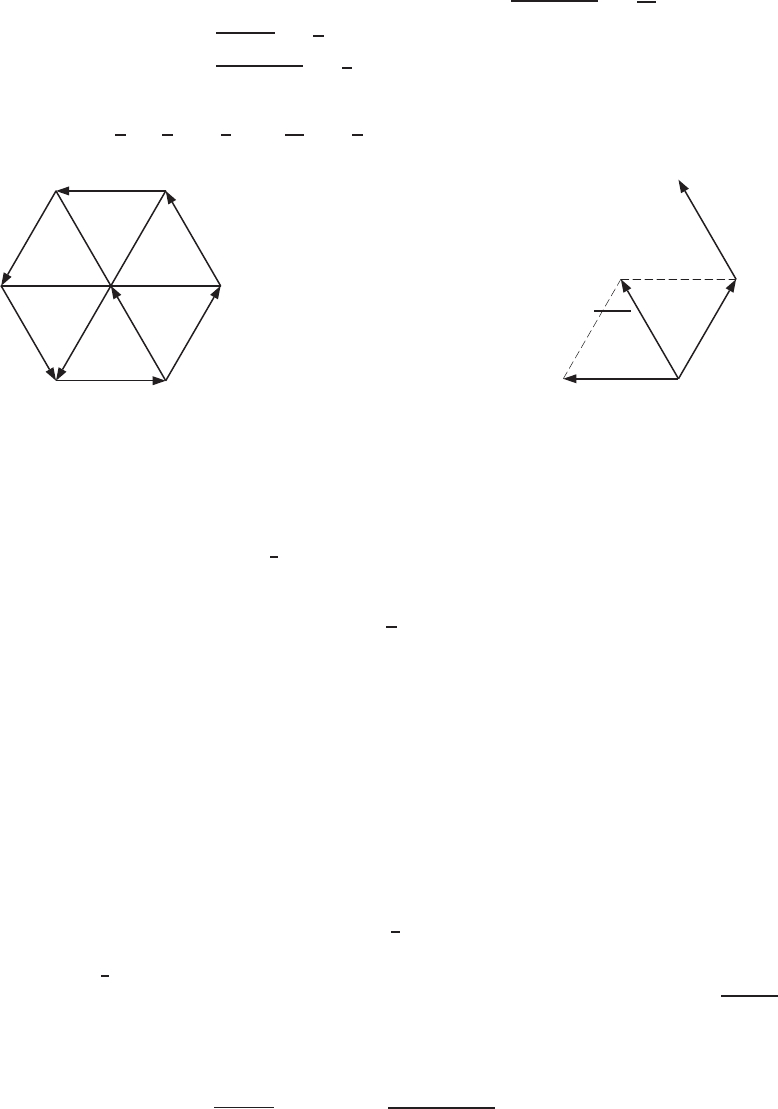
1210 Chapter Thirteen /SOLUTIONS
37. (a) True, by the property of commutativity.
(b) It does not make sense, we cannot add vectors and scalars.
(c) True, by the property of commutativity.
(d) This is not always true. For example, let ~a =~
i+ 2~
j,~
b=−2
~
i+~
j. Then
k~a +~
bk=k~
i+ 2~
j−2
~
i+~
jk=k −~
i+ 3~
jk=p(−1)2+ 32=√10
k~a k=p12+ 22=√5
k~
bk=p(−2)2+ 12=√5.
So, k~a k+k~
bk=√5 + √5 = 2√5. But √10 6= 2√5and k~a +~
bk 6=k~a k+k~
bk.
38.
~v
~y
~z
~w
~x
−~v ~w
~u
Figure 13.5
−~u
~v
~w
✲
~w =~v + (−~u )
Figure 13.6
Break the hexagon up into 6 equilateral triangles, as shown in Figure 13.5.
Then ~u −~v +~w =~
0, so ~w =~v −~u
Similarly, ~x =−~u ,~y =−~v ,~z =−~w =~u −~v .
39. (a) We need 6
~
i+ 8~
j+ 3~
k=λ(2
~
i+ (t2+2
3t+ 1)~
j+t~
k)for some λ. This gives
6 = 2λ
8 = (t2+2
3t+ 1)λ
3 = tλ
From the first equation, we have λ= 3. Substituting λ= 3 into the third equation gives t= 1. Check the second
equation, it says 8 = 8, if t= 1 and λ= 3. So for t= 1, the two vectors are parallel to each other.
(b) Similar to part (a), we need to solve
2 = tλ
−4 = λ
1 = λ(t−1)
From the first two equations we have λ=−4and t=−1
2. Substituting this into the third equation gives 1 = 6.
Thus this system of equations has no solution, so the pair of vectors is not parallel to each other for any value of t.
(c) 2t
~
i+t~
j+t~
k=t
3(6
~
i+ 3~
j+ 3~
k). For any t, the two vectors are parallel to each other.
40. Since the component of ~v in the~
i-direction is 3, we have ~v = 3
~
i+b~
jfor some b. Since k~v k= 5, we have √32+b2=
5, so b= 4 or b=−4. There are two vectors satisfying the properties given: ~v = 3
~
i+ 4~
jand ~v = 3
~
i−4~
j.
41. Let ~v =x
~
i+y~
j.
We want k~v k= 1 and k~v +~
ik= 1, i.e.,
px2+y2= 1 and p(x+ 1)2+y2= 1.
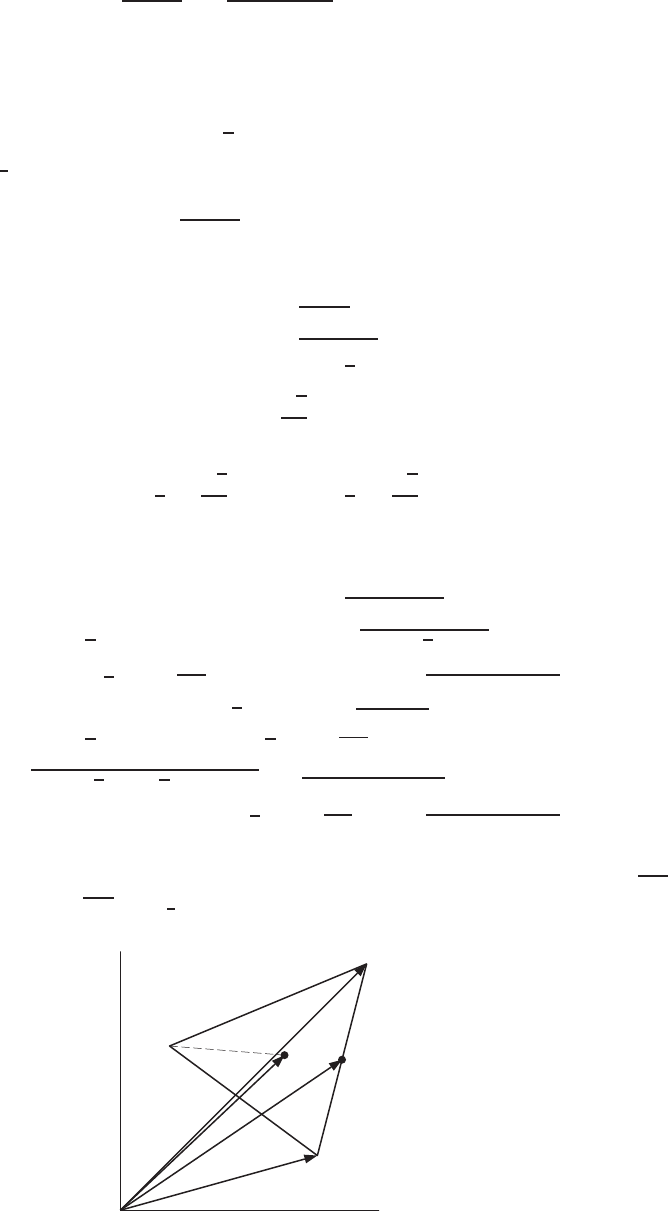
13.1 SOLUTIONS 1211
Setting these equations equal and solving for xgives:
px2+y2=p(x+ 1)2+y2
x2+y2= (x+ 1)2+y2(after squaring both sides)
x2+y2=x2+2x+ 1 + y2
0 = 2x+ 1
x=−1
2.
Since we know x=−1
2, we can use the fact that k~v k= 1 to solve for y:
k~v k= 1
px2+y2= 1
x2+y2= 1
y2= 1 −x2
y=±p1−x2
=±r1−1
22
=±√3
2.
Thus the vectors we are looking for are:
~v =−1
2~
i+√3
2and ~v =−1
2~
i−√3
2~
j .
42. We must check that all the points are the same distance apart, i.e., the magnitude of the displacement vectors −→
OA,−−→
OB,
−−→
OC,−→
BA,−−→
CB and −→
CA is the same. Here goes:
k−→
OAk=k(2
~
i+ 0~
j+ 0~
k)−(0
~
i+ 0~
j+ 0~
k)k=p22+ 02+ 02= 2
k−−→
OBk=k(1
~
i+√3~
j+ 0~
k)−(0
~
i+ 0~
j+ 0~
k)k=q12+ (√3)2+ 02= 2
k−−→
OCk=k(1
~
i+ 1/√3~
j+ 2p2/3~
k)−(0
~
i+ 0~
j+ 0~
k)k=p1 + 1/3 + 4(2/3) = 2
k−→
BAk=k(2
~
i+ 0~
j+ 0~
k)−(1
~
i+√3~
j+ 0~
k)k=√1 + 3 + 0 = 2
k−−→
CBk=k(1
~
i+√3~
j+ 0~
k)−(1
~
i+ 1/√3~
j+ 2p2/3~
k)k
=q02+ (√3−1/√3)2+ 4(2/3) = p3−2 + 1/3 + 8/3 = 2
k−→
CAk=k(2
~
i+ 0~
j+ 0~
k)−(1
~
i+ 1/√3~
j+ 2p2/3~
k)k=p1 + 1/3 + 4(2/3) = 2.
43. In Figure 13.7 let Obe the origin, points A,B, and Cbe the vertices of the triangle, point Dbe the midpoint of BC, and
Qbe the point in the line segment DA that is 1
3|DA|away from D.
A
C
B
D
Q
Ox
y
Figure 13.7
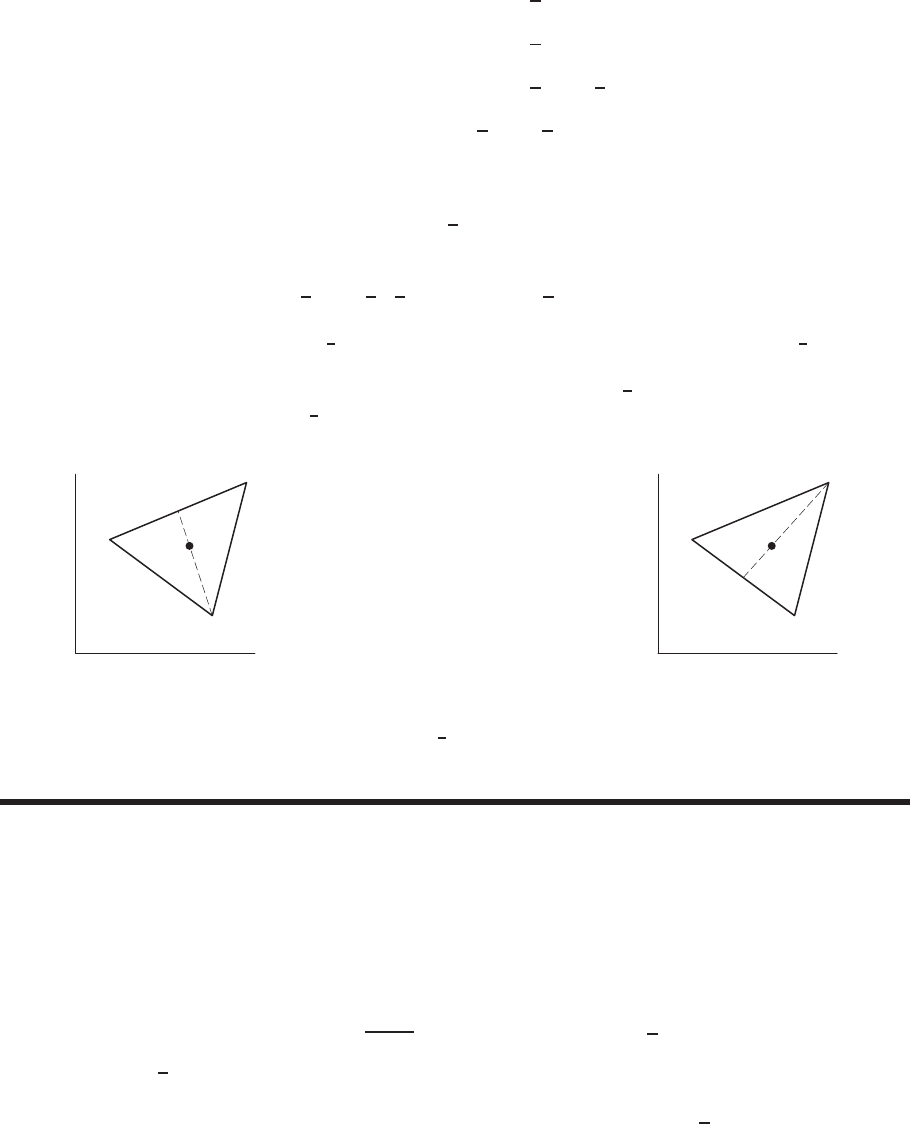
1212 Chapter Thirteen /SOLUTIONS
From Figure 13.7 we see that
−−→
OQ =−−→
OD +−−→
DQ =−−→
OD +1
3−−→
DA
=−−→
OD +1
3(−→
OA −−−→
OD)
=−−→
OD +1
3−→
OA −1
3−−→
OD
=1
3−→
OA +2
3−−→
OD.
Because the diagonals of a parallelogram meet at their midpoint, and 2−−→
OD is a diagonal of the parallelogram formed by
−−→
OB and −−→
OC, we have:
−−→
OD =1
2(−−→
OB +−−→
OC),
so we can write:
−−→
OQ =1
3−→
OA +2
31
2(−−→
OB +−−→
OC) = 1
3(−→
OA +−−→
OB +−−→
OC).
Thus a vector from the origin to a point 1
3of the way along median AD from D, the midpoint, is given by 1
3(−→
OA +−−→
OB +
−−→
OC).
In a similar manner we can show that the vector from the origin to the point 1
3of the way along any median from the
midpoint of the side it bisects is also 1
3(−→
OA +−−→
OB +−−→
OC). See Figure 13.8 and 13.9.
A
C
B
Q
x
y
Figure 13.8
A
C
B
Q
x
y
Figure 13.9
Thus the medians of a triangle intersect at a point 1
3of the way along each median from the side that each bisects.
Strengthen Your Understanding
44. The number k~u +~v kcould be less than 1. For example, for ~u =~
iand ~v =−0.5
~
i,~u +~v = 0.5
~
iand k~u +~v k=
0.5<1.
45. If c < 0, then c~u has the opposite direction of ~u . Also, if c= 0, then c~v =~
0, which has no direction at all.
46. If the angle between the vectors ~u and ~v is more than 90◦, then k~v −~u kis the length of the longer diagonal of the
parallelogram.
47. Since ~u +~w =~u , we see that ~w =~u −~u =~
0.Since ~w is the zero vector, this means ~v +~w =~v +~
0 = ~v .
48. Since ~v lies on a plane parallel to the yz-plane it must have a zero~
i-component. So ~v =a~
j+b~
k. If we choose a= 1,
then ~v =~
j+b~
k. Now we set:
k~v k=p1 + b2= 2,which gives b=±√3.
So, ~v =~
j+√3~
kis a possible answer.
49. Take any equilateral triangle P QR whose sides have length one. Let ~u =−−→
P Q and ~v =−→
P R, which are unit vectors.
Then ~v −~u =−→
QR, which is also a unit vector. The vectors ~u =~
iand ~v = (1/2)
~
i+ (√3/2)~
jwork, for example.
50. Since ~w is the difference between ~u and ~v we have ~w =~v −~u , or 2
~
i+ 3~
j=~v −~u . Solving for ~v we get
~v = 2
~
i+ 3~
j+~u . We can choose any vector we wish for ~u and compute the corresponding vector ~v . For example, if
we let u=~
ithen we get ~v = 3
~
i+ 3~
j.
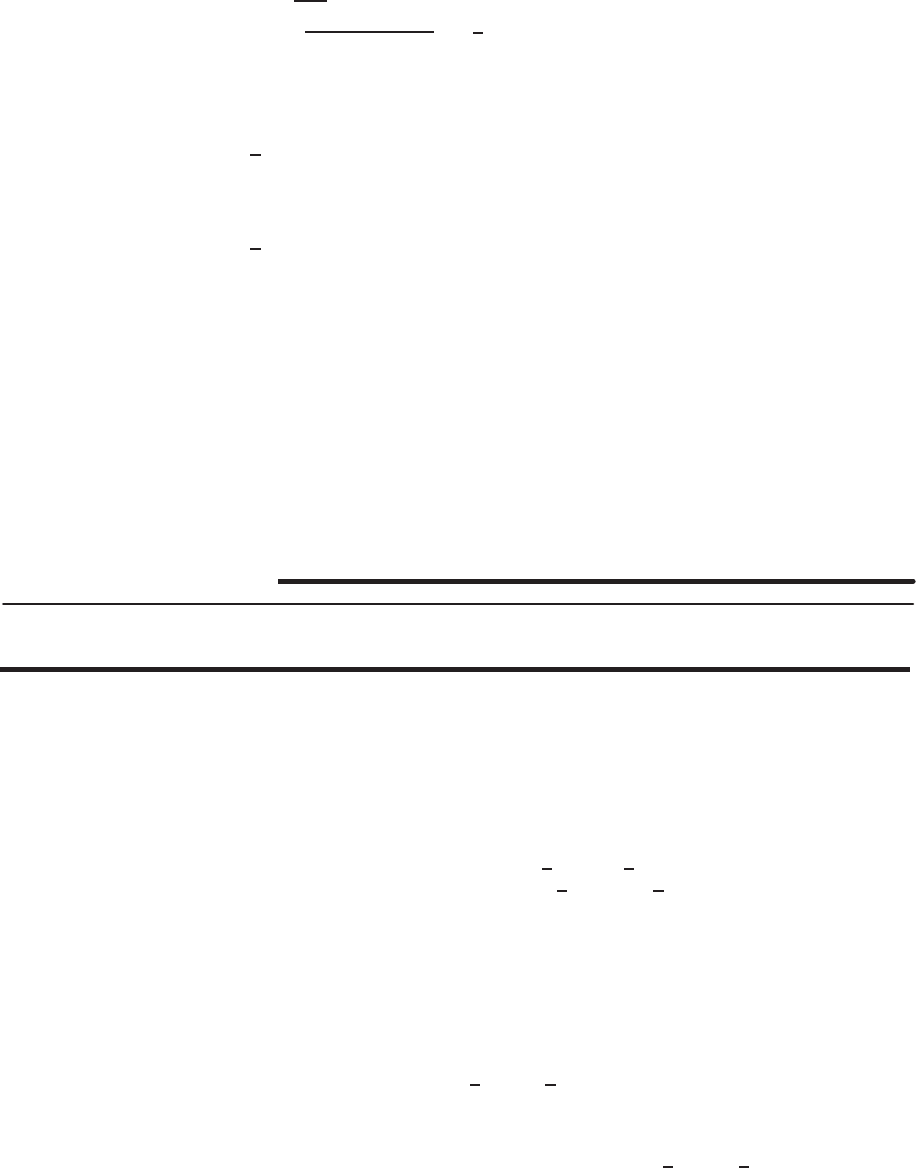
13.2 SOLUTIONS 1213
51. False. There are exactly two unit vectors: one in the same direction as ~v and the other in the opposite direction. Explicitly,
the unit vectors parallel to ~v are ±1
k~v k~v .
52. False. The length of this vector is p1/3 + 1/3 + 4/3 = √2, not 1.
53. True. Multiplying by a scalar greater than one stretches the length of the vector by the scalar.
54. False. If ~v and ~w are not parallel, the three vectors ~v ,~w and ~v +~w can be thought of as three sides of a triangle. (If
the tail of ~w is placed at the head of ~v , then ~v +~w is a vector from the tail of ~v to the head of ~w .) The length of one
side of a triangle is less than the sum of the lengths of the other two sides. Alternatively, a counterexample is ~v =~
iand
~w =~
j. Then k~
i+~
jk=√2but k~
ik+k~
jk= 2.
55. False. If ~v and ~w are not parallel, the three vectors ~v ,~w and ~v −~w can be thought of as three sides of a triangle. (If
the tails of ~v and ~w are placed together, then ~v −~w is a vector from the head of ~w to the head of ~v .) The length of one
side of a triangle is less than the sum of the lengths of the other two sides. Alternatively, a counterexample is ~v =~
iand
~w =~
j. Then k~
i−~
jk=√2but k~
ik − k~
jk= 0.
56. False. Two vectors are parallel if and only if one is a nonzero scalar multiple of the other. If c(
~
i−2~
j+~
k) = 2
~
i−~
j+~
k,
then c= 2 so that the~
icomponents are equal, but multiplication by 2does not make the ~
jor ~
kcomponents equal. Thus,
there is no scalar multiple of~
i−2~
j+~
kthat is equal to 2
~
i−~
j+~
k.
57. False. As a counterexample, take 3
~
iand −~
i. Then the sum is 2
~
iwhich has magnitude 2 (smaller than k3
~
ik= 3).
58. False. Since magnitudes are nonnegative this cannot be true when c < 0. The correct statement is kc~v k=|c|k~v k.
59. False. To find the displacement vector from (1,1,1) to (1,2,3) we subtract ~
i+~
j+~
kfrom ~
i+ 2~
j+ 3~
kto get
(1 −1)
~
i+ (2 −1)~
j+ (3 −1)~
k=~
j+ 2~
k.
60. False. The displacement vector from (a, b)to (c, d)has the same magnitude but opposite direction as the displacement
vector from (c, d)to (a, b).
Solutions for Section 13.2
Exercises
1. Scalar
2. Scalar
3. Temperature is measured by a single number, and so is a scalar.
4. The magnetic field is a vector because it has both a magnitude (the strength of the field) and a direction (the direction of
the compass).
5. Writing ~
P= (P1, P2,···, P50)where Piis the population of the ith state, shows that ~
Pcan be thought of as a vector
with 50 components.
6. In components, we have ~v = 10 cos(45◦)
~
i−10 sin(45◦)~
j= (5√2)
~
i−(5√2)~
j= 7.07
~
i−7.07~
j. Notice that the
coefficient in the ~
j-direction must be negative. The components are 5√2~
iand −5√2~
j.
7. In components, we have ~v =−40 cos(20◦)
~
i−40 sin(20◦)~
j=−37.59
~
i−13.68~
j. Notice that both coefficients are
negative. The components are −37.59
~
iand −13.68~
j.
8. (a) If the car is going east, it is going solely in the positive xdirection, so its velocity vector is 50
~
i.
(b) If the car is going south, it is going solely in the negative ydirection, so its velocity vector is −50~
j.
(c) If the car is going southeast, the angle between the x-axis and the velocity vector is −45◦. Therefore
velocity vector = 50 cos(−45◦)
~
i+ 50 sin(−45◦)~
j
= 25√2
~
i−25√2~
j .
(d) If the car is going northwest, the velocity vector is at a 45◦angle to the y-axis, which is 135◦from the x-axis.
Therefore:
velocity vector = 50(cos 135◦)
~
i+ 50(sin 135◦)~
j=−25√2
~
i+ 25√2~
j .
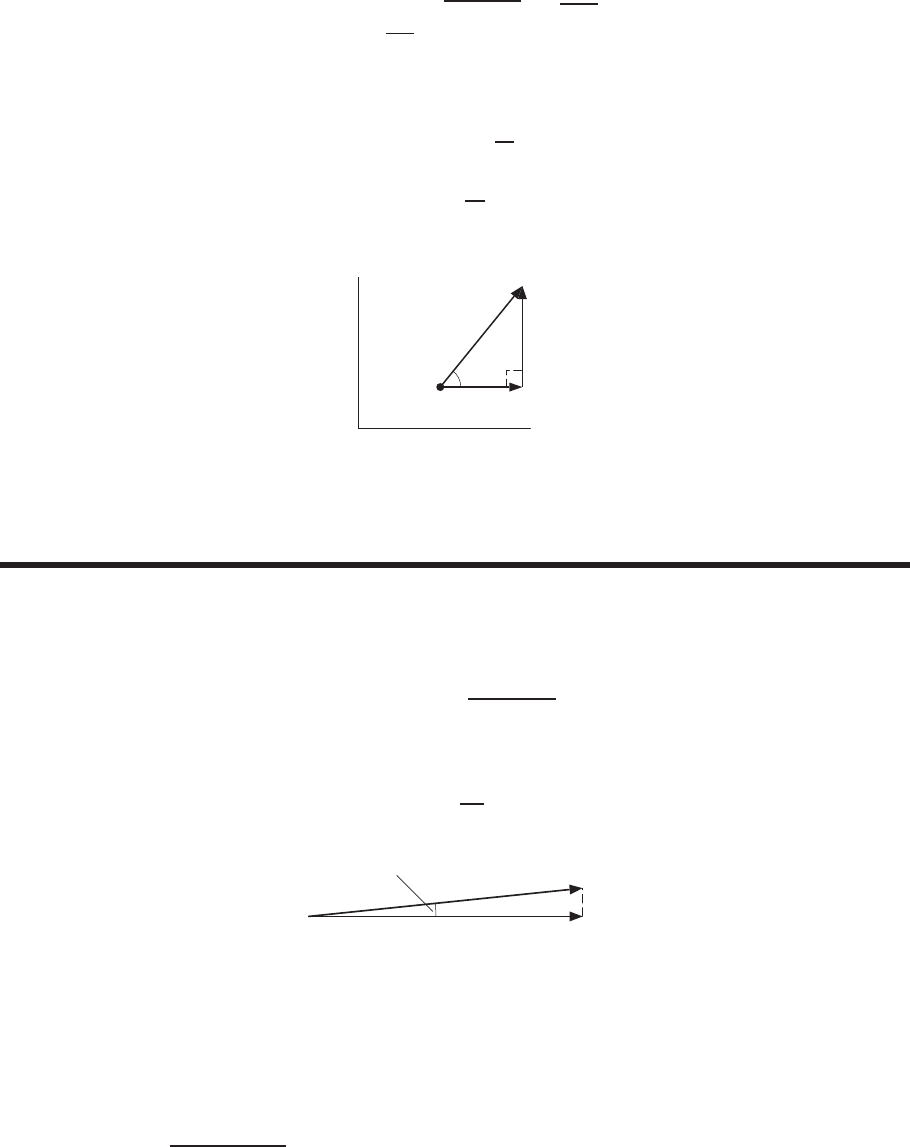
1214 Chapter Thirteen /SOLUTIONS
9. We need to calculate the length of each vector.
k21
~
i+ 35~
jk=p212+ 352=√1666 ≈40.8,
k40
~
ik=√402= 40.
So the first car is faster.
10. See Figure 13.10. Since
tan θ=18
15 ,
we have
θ= arctan 18
15 = 50.194◦.
15
~
i
18~
j
~
F
θ
x
y
Figure 13.10
Problems
11. (a) We start by finding the velocity, ~w , of the boat relative to the riverbed. It is given by
~w =~v +~c = 8
~
i+ (0.6
~
i+ 0.8~
j) = 8.6
~
i+ 0.8~
j .
The speed of the boat relative to the riverbed is the magnitude of ~w :
Speed =k~w k=p8.62+ 0.82≈8.64 km/hr.
(b) Since the velocity, ~v = 8
~
i, is parallel to the x-axis, we want to find the angle between ~w and the x-axis. From
Figure 13.11, this angle is
θ= arctan 0.8
8.6≈0.093 radians.
❘
θ
8.6
0.8
~w
Figure 13.11
: Angle between ~v and ~w
In practical terms, this angle tells us that if you set your boat parallel to the x-axis at 8 km/hr, the current will
take you about 0.093 radians ≈5◦off course.
12. Now ~c =−2(0.6
~
i+ 0.8~
j) = −1.2
~
i−1.6~
j. The velocity vector for the boat relative to the riverbed is
~w =~v +~c = (8 −1.2)
~
i−1.6~
j= 6.8
~
i−1.6~
j
so the speed is p6.82+ (−1.6)2= 6.986 km/hr.

13.2 SOLUTIONS 1215
13. (a) The velocity vector for the boat is ~
b= 25
~
iand the velocity vector for the current is
~c =−10 cos(45◦)
~
i−10 sin(45◦)~
j=−7.07
~
i−7.07~
j .
The actual velocity of the boat is ~
b+~c = 17.93
~
i−7.07~
j .
(b) k~
b+~c k= 19.27 km/hr.
(c) We see in Figure 13.12 that tan θ=7.07
17.93 , so θ= 21.52◦south of east.
✻
❄
7.07
✲✛ 17.93
θ
~
b
~c
~
b+~c
Figure 13.12
14.
30 km/hr
truck
✻
~r
40 km/hr
Police car
✛
x
East
North
y
C
Police car
P
Truck
O
Figure 13.13
Since both vehicles reach the crossroad in exactly one hour, at the present the truck is at Oin Figure 13.13; the police
car is at Pand the crossroads is at C. If ~r is the vector representing the line of sight of the truck with respect to the police
car.
~r =−40
~
i−30~
j
15. Suppose ~u represents the velocity of the plane relative to the air and ~w represents the velocity of the wind. We can add
these two vectors by adding their components. Suppose north is in the y-direction and east is the x-direction. The vector
representing the airplane’s velocity makes an angle of 45◦with north; the components of ~u are
~u = 700 sin 45◦~
i+ 700 cos 45◦~
j≈495
~
i+ 495~
j .
Since the wind is blowing from the west, ~w = 60
~
i. By adding these we get a resultant vector ~v = 555
~
i+ 495~
j. The
direction relative to the north is the angle θshown in Figure 13.14 given by
θ= tan−1x
y= tan−1555
495
≈48.3◦
The magnitude of the velocity is
k~v k=p4952+ 5552=p553,050
= 744 km/hr.
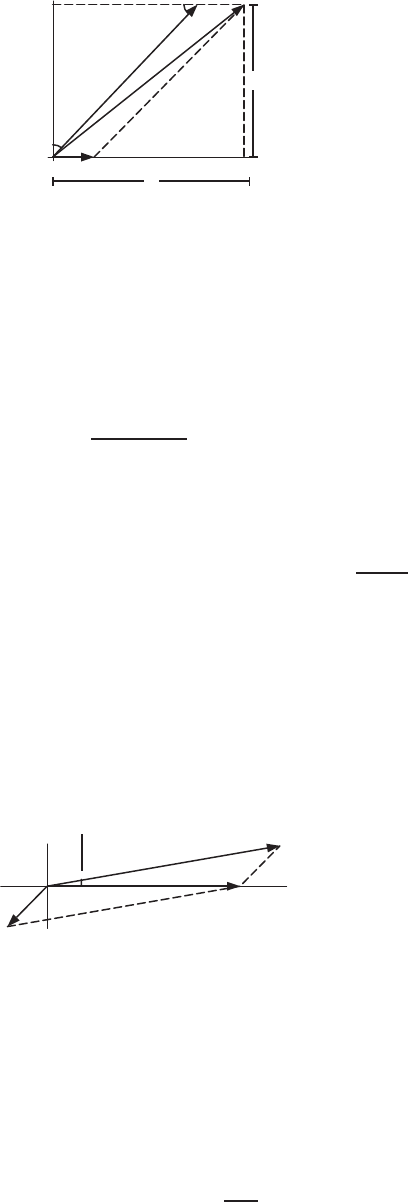
1216 Chapter Thirteen /SOLUTIONS
~w
θ
~u
~v
E
N
45◦
0✲✛ x
✻
❄
y
Figure 13.14
: Note that θis the angle between north and the vector ~v
16. We want the total force on the object to be zero. We must choose the third force ~
F3so that ~
F1+~
F2+~
F3= 0. Since
~
F1+~
F2= 11
~
i−4~
j, we need ~
F3=−11
~
i+ 4~
j.
17. The velocity vector for the wind is ~w = 60 cos(45◦)
~
i−60 sin(45◦)~
j= 42.43
~
i−42.43~
j. If the airplane is to head
due east, then the component in the ~
j-direction of ~p +~w must be zero (where ~p represents the velocity vector for the
airspeed of the plane.) Thus, we have ~p =A
~
i+ 42.43~
j, for some value of A. Since the airplane is flying at an airspeed
of 500 km/hr, we have
k~p k= 500
pA2+ 42.432= 500
A= 498.20.
We have
~p = 498.20
~
i+ 42.43~
j .
This is the direction the plane should head in order to go due east. We use tan θ=42.43
498.20 , so θ= 4.87◦. The plane
should head 4.87◦north of east. Since
~p +~w = 540.63
~
i ,
the airplane’s speed relative to the ground is k~p +~w k= 540.63 km/hr.
18. Let the x-axis point east and the y-axis point north. Since the wind is blowing from the northeast at a speed of 50 km/hr,
the velocity of the wind is
~w =−50 cos 45◦~
i−50 sin 45◦~
j≈ −35.4
~
i−35.4~
j .
Let ~a be the velocity of the airplane, relative to the air, and let φbe the angle from the x-axis to ~a ; since k~a k=
600 km/hr, we have ~a = 600 cos φ
~
i+ 600 sin φ~
j. (See Figure 13.15.)
~w
~a
~v
❄
φ
x
y
Figure 13.15
Now the resultant velocity, ~v , is given by
~v =~a +~w = (600 cos φ
~
i+ 600 sin φ~
j) + (−35.4
~
i−35.4~
j)
= (600 cos φ−35.4)
~
i+ (600 sin φ−35.4)~
j .
Since the airplane is to fly due east, i.e., in the xdirection, then the y-component of the velocity must be 0, so we must
have
600 sin φ−35.4 = 0
sin φ=35.4
600 .
Thus φ= arcsin(35.4/600) ≈3.4◦.
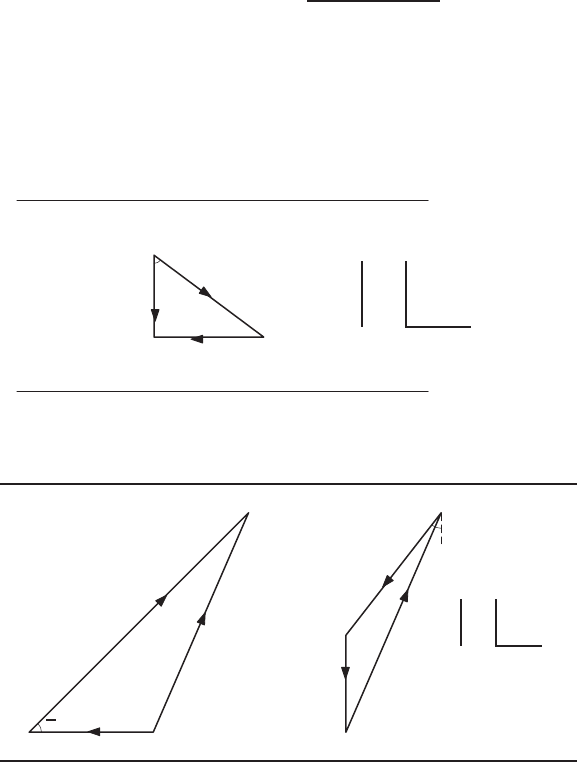
13.2 SOLUTIONS 1217
19. Let the x-axis point east and the y-axis point north. We use ~
C,~
W, and ~
Eto represent the current, wind, and engine
vectors, respectively. We resolve the current and wind velocity vectors into components. Since the current points 25◦
north of east with a speed of 12, we have
~
C= 12 cos(25◦)
~
i+ 12 sin (25◦)~
j= 10.876
~
i+ 5.071~
j .
Since ~
Clies in the first quadrant, both coefficients are positive.
The wind points 80◦south of east with a speed of 7 km/hr, so we have
~
W= 7 cos(80◦)
~
i−7 sin (80◦)~
j= 1.216
~
i−6.894~
j .
Since ~
Wlies in the fourth quadrant, the coefficient of~
iis positive and the coefficient of ~
jis negative.
The combined velocity on the boat is due east at a speed of 40 km/hr, so we want
~
C+~
W+~
E= 40
~
i .
We solve for ~
E:
~
E= 40
~
i−(~
C+~
W)
= 40
~
i−((10.876
~
i+ 5.071~
j) + (1.216
~
i−6.894~
j))
= 40
~
i−(12.092
~
i−1.823~
j)
= 27.908
~
i+ 1.823~
j .
The engine should push the boat with a speed of k~
Ek=√27.9082+ 1.8232= 27.97 km/hr, and in direction
arctan(1.823/27.908) = 3.74◦north of east.
20. (a) Let x-axis be the East direction and y-axis be the North direction. From Figure 13.16,
θ= sin−1(4/5) = 53.1◦.
That is, he should steer at 53.1◦east of south.
*
*
*
✲
✻✻
x
y
N
θ
5 km/hr
Steering direction
4 km/hr
Figure 13.16
(b)
✲
✻✻
x
y
N
θ
4 km/hr
π
4
10 km/hr
~
R
5 km/hr
~
R
Figure 13.17
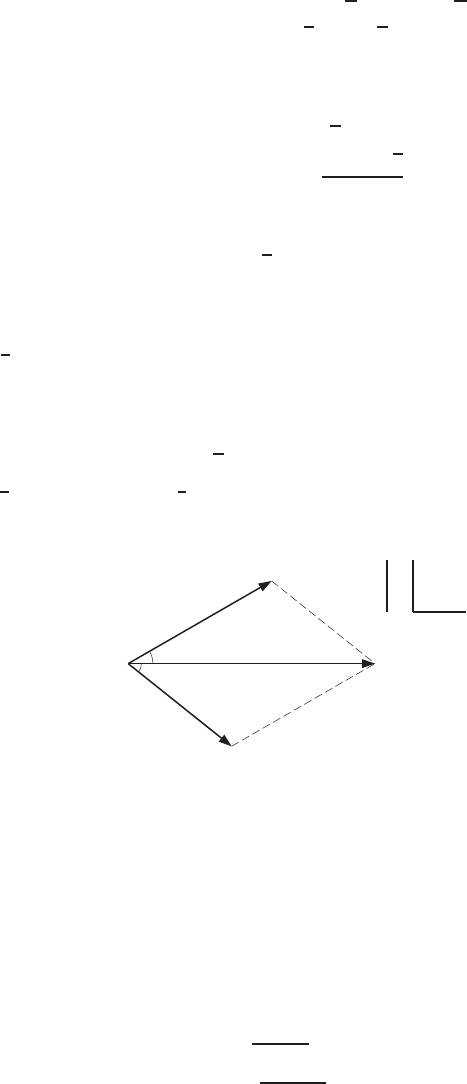
1218 Chapter Thirteen /SOLUTIONS
Let ~
Rbe the resultant of the wind and river velocities, that is
~
R=−4
~
i+ (10 cos( π
4)
~
i+ 10 cos( π
4)~
j)
= (−4 + 5√2)
~
i+ 5√2~
j .
From Figure 13.17, we see that to get the the x-component of his rowing velocity and the x-component of ~
Rto
cancel each other, we must have
5 sin θ=−4 + 5√2
θ= sin−1−4+ 5√2
5= 37.9◦.
However for this value of θ, the y-component of the velocity is
5√2−5 cos(37.9◦) = 3.1.
Since the y-component is positive, the man will not move across the river in a southward direction.
21. Let ~
Rbe the resultant force, and let ~
F1and ~
F2be the forces exerted by the larger and smaller tugs. See Figure 13.18.
Then k~
F1k=5
4k~
F2k. The ycomponents of the vectors ~
F1and ~
F2must cancel each other in order to ensure that the
ship travels due east, hence
k~
F1ksin 30◦=k~
F2ksin θ,
so 5
4k~
F2ksin 30◦=k~
F2ksin θ,
giving sin θ=5
8,and hence θ= sin−15
8= 38.7◦.
30◦~
R
~
F1
~
F2
θ
✻
✲
✻
x
y
N
Figure 13.18
22. The known force is
~
F1= 15 cos 20◦~
i+ 15 sin 20◦~
j= 14.1
~
i+ 5.13~
jpounds.
Let the unknown force be ~
F2=a
~
i+b~
j.
Because ~
F1and ~
F2together pull due east, we have ~
F1+~
F2=k
~
ifor a positive constant k. Thus
(15 cos 20◦+a)
~
i+ (15 sin 20◦+b)~
j=k
~
i+ 0~
j .
Hence
b=−15 sin 20◦=−5.1pounds.
Because ~
F2has magnitude 20 pounds, we have √a2+b2= 20. Thus
a=p202−b2= 19.3pounds
where the positive square root is required because the sum ~
F1+~
F2points east and not west. Thus
~
F2= 19.3
~
i−5.1~
jpounds.
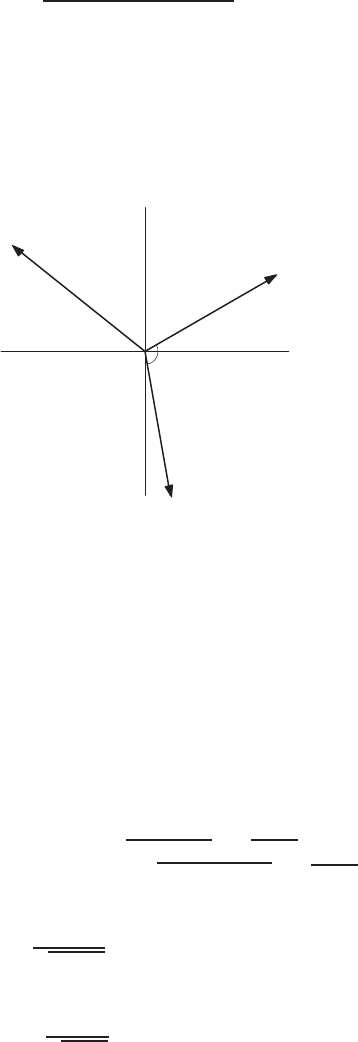
13.2 SOLUTIONS 1219
23. The force exerted on the object from the first rope ~
F1= 100 cos(30◦)
~
i+ 100 sin(30◦)~
j= 86.60
~
i+ 50~
jand the force
exerted from the second rope is ~
F2= 70 cos(80◦)
~
i−70 sin(80◦)~
j= 12.16
~
i−68.94~
j. The sum of these two forces
is ~
F1+~
F2= 98.76
~
i−18.94~
j. See Figure 13.19. In order for the object to move vertically, the total force on the object
must be in the form ~
F= 0
~
i+ 0~
j+b~
kfor some b. Thus the force vector for the crane is
~
Fc=−98.76
~
i+ 18.94~
j+b~
k
for some b. To find b, we use the fact that k~
Fck= 3000. Thus,
k~
Fck= 3000
p(98.76)2+ (18.94)2+b2= 3000
b=±2998.31
We use the positive value of bsince we want the object to go up rather than down. The force exerted by the crane is
~
Fc=−98.76
~
i+ 18.94~
j+ 2998.31~
k .
The total force acting on the object is 2998.31~
k, or 2998.31 newtons straight up.
~
Fc
~
F1= 100
newtons
~
F2= 70
newtons
30◦
80◦
N
S
EW
Figure 13.19
: Horizontal forces on object
24. (a) The displacement vector of the moon relative to the earth is
~r = 384
~
i .
The displacement vector of the spaceship relative to the earth is
~rE= 280
~
i+ 90~
j .
The displacement vector of the spaceship relative to the moon is
~rL=~rE−~r =−104
~
i+ 90~
j .
See Figure 13.20.
(b) Distance of spaceship from Earth =|| ~rE|| =√2802+ 902=√86500 = 294.109 thousand km.
Distance of spaceship from the moon =|| ~rL|| =p(−104)2+ 902=√18916 = 137.535 thousand km.
(c) See Figure 13.20. The gravitational force of the earth, −→
FE, is parallel to ~rEbut of length 461 and in the opposite
direction: −→
FE=−461
√186500 (280
~
i+ 90~
j) = −438.885
~
i−141.070~
j .
The gravitational force of the moon, −→
FL, is parallel to ~rLbut of length 26 and in the opposite direction:
−→
FL=−26
√18916 (−104
~
i+ 90~
j) = 19.660
~
i−17.041~
j .
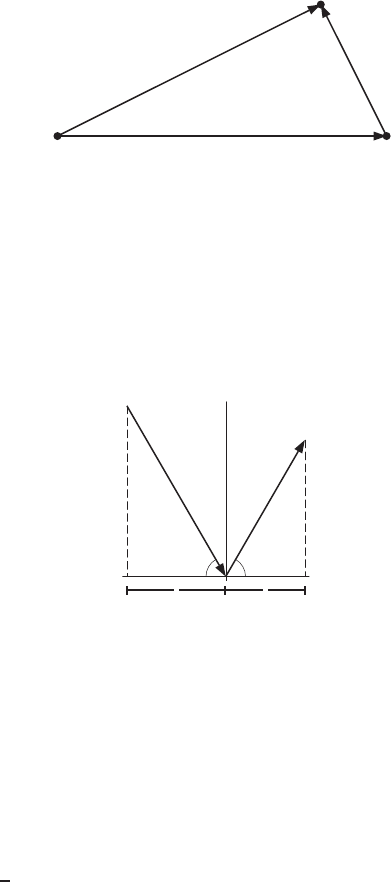
1220 Chapter Thirteen /SOLUTIONS
The resulting force, ~
Fis
~
F=−→
FE+−→
FL= 419.225
~
i−158.084~
j .
Earth
~r E= 280
~
i+ 90~
j
Spacecraft
~r L
Moon
~r = 384
~
i
Figure 13.20
25. The speed of the particle before impact is v, so the speed after impact is 0.8v. If we consider the barrier as being along
the x-axis (see Figure 13.21), then the~
i-component is 0.8vcos 60◦= 0.8v(0.5) = 0.4v.
Similarly, the ~
j-component is 0.8vsin 60◦= 0.8v(0.8660) ≈0.7v. Thus
~v after = 0.4v~
i+ 0.7v~
j .
~v before
~v after
vsin 60◦
0.8vsin 60◦
60◦60◦
✲✛
vcos 60◦✲✛
0.8vcos 60◦
x
y
Figure 13.21
26. The total scores are out of 300 and are given by the total score vector ~v + 2 ~w :
~v + 2 ~w = (73,80,91,65,84) + 2(82,79,88,70,92)
= (73,80,91,65,84) + (164,158,176,140,184)
= (237,238,267,205,268).
To get the scores as a percentage, we divide by 3, giving
1
3(237,238,267,205,268) ≈(79.00,79.33,89.00,68.33,89.33).
27. Since there are 16 ounces in a pound, we multiply the vector by 1/16 to get 0.01875
~
i+ 0.0125~
j+ 0.03125~
kin dollars
per ounce.
28. (a) Since the radius of the circle is 1meter, the circumference is 2πmeters. Thus, the object is moving at 2πme-
ters/minute, or π/30 meters/second ≈0.11 meters/second.
(b) 30 seconds after passing the point (0,1), the object is at the point (−1,0). (Since it completes 1revolution each
minute, it will move πradians in 30 seconds.) This is true regardless of whether the point is moving clockwise
or counterclockwise. However, since the velocity vector, ~v , is tangential to the curve in the direction of motion, it
will have an opposite sign if the motion is in the opposite direction. So, moving clockwise ~v = 2π~
j, and moving
counterclockwise ~v =−2π~
j, if the speed is measured in meters/minute.
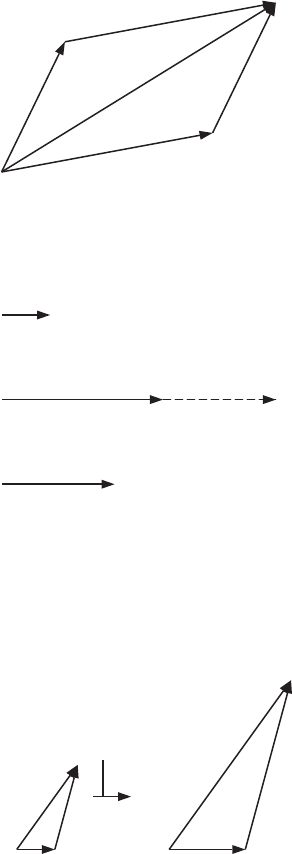
13.2 SOLUTIONS 1221
29. The speed is a scalar which equals 30 times the circumference of the circle per minute. So it is a constant. The velocity is a
vector. Since the direction of the motion changes all the time, the velocity is not constant. This implies that the acceleration
is nonzero.
30.
O
A
B
C
~v
~w
~w
~v
Figure 13.22
The vector ~v +~w is equivalent to putting the vectors −→
OA and −→
AB end-to-end as shown in Figure 13.22; the vector
~w +~v is equivalent to putting the vectors −−→
OC and −−→
CB end-to-end. Since they form a parallelogram, ~v +~w and ~w +~v
are both equal to the vector −−→
OB, we have ~v +~w =~w +~v .
31.
β~v
α~v
~v
β~v
Figure 13.23
The vectors ~v ,α~v and β~v are all parallel. Figure 13.23 shows them with α,β > 0, so all the vectors are in the same
direction. Notice that α~v is a vector αtimes as long as ~v and β~v is βtimes as long as ~v . Therefore α~v +β~v is a vector
(α+β)times as long as ~v , and in the same direction. Thus,
α~v +β~v = (α+β)~v .
32.
~v +~w ~w
~v
❄
scaling
by
α
α(~v +~w )
α~v
α ~w
Figure 13.24
The effect of scaling the left-hand picture in Figure 13.24 is to stretch each vector by a factor of α(shown with
α > 1). Since, after scaling up, the three vectors α~v ,α ~w , and α(~v +~w )form a similar triangle, we know that α(~v +~w )
is the sum of the other two: that is
α(~v +~w ) = α~v +α ~w .
33. Assume α, β > 0. The vector β~v is in the same direction and βtimes as long as ~v . The vector α(β~v )is in the same
direction and αtimes as long as β~v , and so is αβ times as long as ~v and in the same direction as ~v . Thus,
α(β~v ) = (αβ)~v .
34. Since the zero vector has zero length, adding it to ~v has no effect.
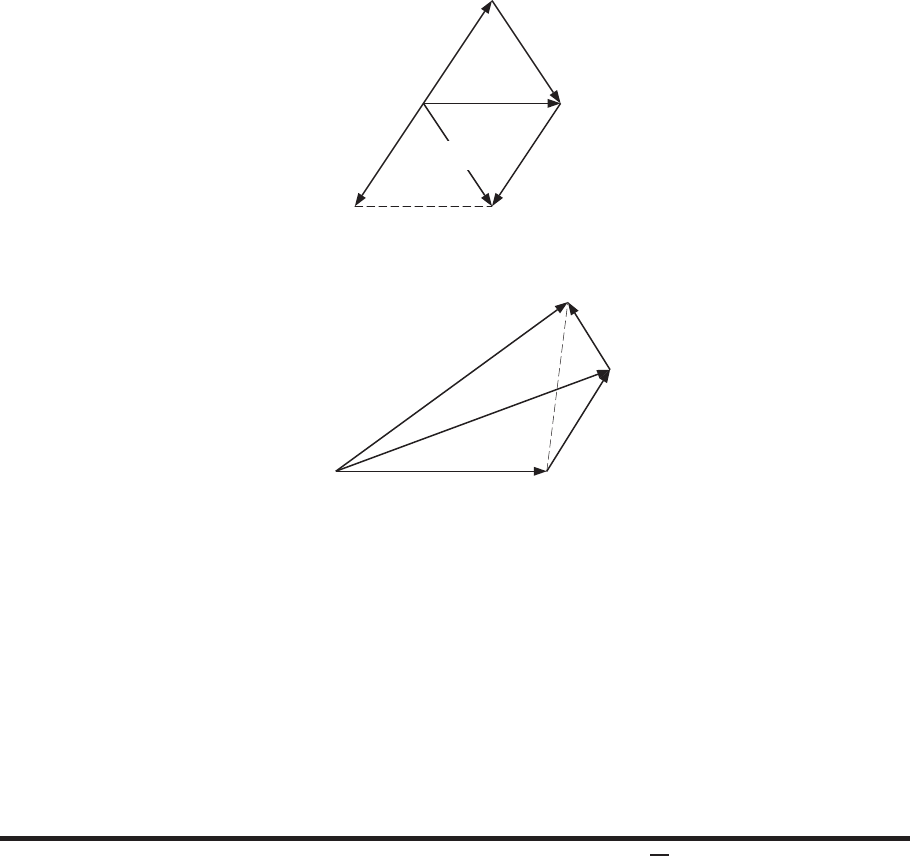
1222 Chapter Thirteen /SOLUTIONS
35. According to the definition of scalar multiplication, 1·~v has the same direction and magnitude as ~v , so it is the same as
~v .
36. By Figure 13.25, the vectors ~v + (−1) ~w and ~v −~w are equal.
-
~v
~w ~v −~w
(−1) ~w
(−1) ~w
~v + (−1) ~w
Figure 13.25
37.
OA
B
C
~u
~v
~w
Figure 13.26
The vector ~u +~v is represented by −−→
OB. The vector (~u +~v ) + ~w is represented by −−→
OB followed by −−→
BC, which
is therefore −−→
OC. Now ~v +~w is represented by −→
AC. So ~u + (~v +~w )is −→
OA followed by −→
AC, which is −−→
OC. Since we
get the vector −−→
OC by both methods, we know
(~u +~v ) + ~w =~u + (~v +~w )
38. (a) Target Ais at the point (30,0,3); Target Bis at the point (20,15,0); Target Cis the point (12,30,8). You fire
from the point P= (0,0,5). The vectors to each of these targets are −→
P A = 30
~
i−2~
k,−−→
P B = 20
~
i+ 15~
j−5~
k,
−−→
P C = 12
~
i+ 30~
j+ 3~
k.
(b) You fire from the point Q= (0,−1,3), so −→
QA = 30
~
i+~
j,−−→
QB = 20
~
i+ 16~
j−3~
k,−−→
QC = 12
~
i+ 31~
j+ 5~
k.
Strengthen Your Understanding
39. The vectors ~v = 2
~
i+ 3~
j+~
kand ~w = 3
~
i+ 2~
j+~
khave both magnitude √14 and the same ~
k-component, but
different~
i-components and ~
j-components, so they are not the same vector.
40. If the ~
j-component of ~v is larger than or equal to 2 (or smaller than or equal to −2), then the magnitude of ~v is greater
than the magnitude of ~w . For example, ~v = 0.5
~
i+ 2~
j.
41. Writing ~
F=a
~
i+b~
j, we have:
~
R=~
F+~
G= (a+ 1)
~
i+ (b+ 1)~
j .
Choosing a= 1 and b=−2, results in a positive~
i-component and a negative ~
j-component for ~
R. So ~
F=~
i−2~
jis a
possible vector. There are many possible others.
42. If ~u and ~v are not parallel, then ~u , ~v and ~u +~v form a triangle. In any triangle, the length of any side is less than the
sum of the lengths of the other two sides: k~u +~v k<k~u k+k~v k. Instead, choose ~v =c~u , for any c > 0. For example,
let ~u =~
iand ~v = 2
~
i. Then
k~
i+ 2
~
ik=k3
~
ik= 3 = 1 + 2 = k~
ik+k2
~
ik.

13.3 SOLUTIONS 1223
43. Yes. Velocity describes how fast something moves and its direction of travel.
44. No. Speed describes only how fast something moves. It does not specify a direction.
45. Yes. Force describes how hard something is pushed or pulled and the direction of the push or pull.
46. No. Area measures the size of the region occupied by a two-dimension figure or surface, and gives no information about
direction.
47. Yes. Acceleration measures the rate of change of velocity and the direction of the change.
48. No. Volume measures the size of the region occupied by a three-dimension object and gives no information about direction.
Solutions for Section 13.3
Exercises
1. ~a ·~y = (2~
j+~
k)·(4
~
i−7~
j) = −14.
2. ~c ·~y = (
~
i+ 6~
j)·(4
~
i−7~
j) = (1)(4) + (6)(−7) = 4 −42 = −38.
3. ~a ·~
b= (2~
j+~
k)·(−3
~
i+ 5~
j+ 4~
k) = (0)(−3) + (2)(5) + (1)(4) = 0 + 10 + 4 = 14.
4. ~a ·~z = (2~
j+~
k)·(
~
i−3~
j−~
k) = (0)(1) + (2)(−3) + (1)(−1) = 0 −6−1 = −7.
5. ~c ·~a +~a ·~y = (
~
i+ 6~
j)·(2~
j+~
k) + (2~
j+~
k)·(4
~
i−7~
j) = 12 −14 = −2.
6. ~c +~y = (
~
i+ 6~
j) + (4
~
i−7~
j) = 5
~
i−~
j, so
~a ·(~c +~y ) = (2~
j+~
k)·(5
~
i−~
j) = −2.
7. Since ~a ·~
bis a scalar and ~a is a vector, the answer to this equation is a vector parallel to ~a . We have
~a ·~
b= (2~
j+~
k)·(−3
~
i+ 5~
j+ 4~
k) = 0(−3) + 2(5) + 1(4) = 14.
Thus,
(~a ·~
b)·~a = 14~a = 14(2~
j+~
k) = 28~
j+ 14~
k
8. Since ~a ·~y and ~c ·~z are both scalars, the answer to this equation is the product of two numbers and therefore a number.
We have
~a ·~y = (2~
j+~
k)·(4
~
i−7~
j) = 0(4) + 2(−7) + 1(0) = −14
~c ·~z = (
~
i+ 6~
j)·(
~
i−3~
j−~
k) = 1(1) + 6(−3) + 0(−1) = −17
Thus,
(~a ·~y )(~c ·~z ) = 238
9. Since ~c ·~c is a scalar and (~c ·~c )~a is a vector, the answer to this equation is another scalar. We could calculate ~c ·~c , then
(~c ·~c )~a , and then take the dot product ((~c ·~c )~a )·~a . Alternatively, we can use the fact that
((~c ·~c )~a )·~a = (~c ·~c )(~a ·~a ).
Since
~c ·~c = (
~
i+ 6~
j)·(
~
i+ 6~
j) = 12+ 62= 37
~a ·~a = (2~
j+~
k)·(2~
j+~
k) = 22+ 12= 5,
we have,
(~c ·~c )(~a ·~a ) = 37(5) = 185
10. A normal vector can be obtained from the coefficients: ~n = 2
~
i+~
j−~
k.
1224 Chapter Thirteen /SOLUTIONS
11. Rewriting the equation as
2x−2z= 3x+ 3y
or
x+ 3y+ 2z= 0
tells us that a normal vector is
~n =~
i+ 3~
j+ 2~
k .
12. A normal vector can be obtained from the coefficients of x,y,zin the equation of the plane and is: ~n = 1.5
~
i+3.2~
j+~
k.
13. Writing the equation in the form
3x+ 4y−z= 7
shows that a normal vector is
~n = 3
~
i+ 4~
j−~
k
14. Rewriting the equation as
πx −π= (1 −π)y−(1 −π)z+π
gives
πx + (π−1)y+ (1 −π)z= 2π
so a normal vector is
~n =π~
i+ (π−1)~
j+ (1 −π)~
k .
15. The plane is
3x−y+ 4z= 3 ·1−1·5 + 4 ·2
3x−y+ 4z= 6.
16. The plane is
5x+ 4y−z= 5 ·2 + 4(−1) −1·3
5x+ 4y−z= 3.
17. The equation of the plane is
(x−1) −(y−3) + (z−5) = 0,
which can be written as x−y+z= 3.
18. Since the plane is normal to the vector 5
~
i+~
j−2~
kand passes through the point (0,1,−1), an equation for the plane is
5x+y−2z= 5 ·0 + 1 ·1 + (−2) ·(−1) = 3
5x+y−2z= 3.
19. Two planes are parallel if their normal vectors are parallel. Since the plane 2x+ 4y−3z= 1 has normal vector
~n = 2
~
i+ 4~
j−3~
k, the plane we are looking for has the same normal vector and passes through the point (1,0,−1).
Thus the plane we want has equation:
2x+ 4y−3z= 2 ·1 + 4 ·0 + (−3) ·(−1) = 5
20. Two planes are parallel if their normal vectors are parallel. Since the plane 3x+y+z= 4 has normal vector ~n =
3
~
i+~
j+~
k, the plane we are looking for has the same normal vector and passes through the point (−2,3,2). Thus, it
has the equation
3x+y+z= 3 ·(−2) + 3 + 2 = −1.
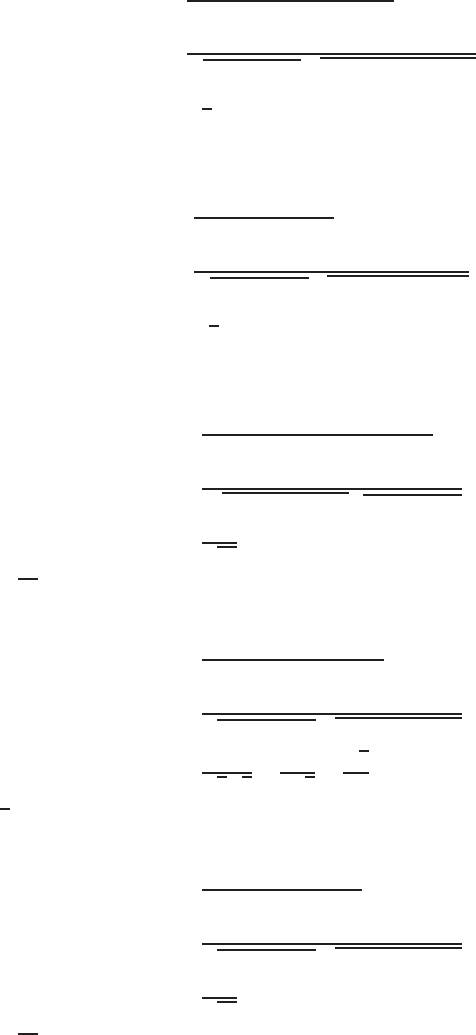
13.3 SOLUTIONS 1225
21. The normal vector to the plane is ~n = 2
~
i−3~
j+ 5~
k, so, for some d, the equation of the plane is
2x−3y+ 5z=d.
Substituting the point (4,5,−2) we see that d=−17. Thus the equation of the plane is
2x−3y+ 5z=−17.
22.
cos θ=(
~
i+~
j+~
k)·(
~
i−~
j−~
k)
k~
i+~
j+~
kkk~
i−~
j−~
kk
=(1)(1) + (1)(−1) + (1)(−1)
√11+ 12+ 12p12+ (−1)2+ (−1)2
=−1
3.
So, θ= arccos(−1/3) ≈1.911 radians, or about 109.471◦.
23.
cos θ=(
~
i+~
k)·(~
j−~
k)
k~
i+~
kkk~
j−~
kk
=(1)(0) + (0)(1) + (1)(−1)
√11+ 02+ 12p02+ (1)2+ (−1)2
=−1
2.
So, θ= arccos(−1/2) = 2π/3radians, or 120◦.
24.
cos θ=(
~
i+~
j−~
k)·(2~
i+ 3~
j+~
k)
k~
i+~
j−~
kkk2~
i+ 3~
j+~
kk
=(1)(2) + (1)(3) + (−1)(1)
p12+ 12+ (−1)2√22+ 32+ 12
=4
√42 .
So, θ= arccos(4/√42) ≈0.906 radians, or ≈51.887◦.
25.
cos θ=(
~
i+~
j)·(
~
i+ 2~
j−~
k)
k~
j+~
jkk~
i+ 2~
j−~
kk
=(1)(1) + (1)(2) + (0)(−1)
√12+ 12+ 02p12+ 22+ (−1)2
=3
√2√6=3
2√3=√3
2.
So, θ= arccos(√3/2) = π/6radians, or 30◦.
26.
cos θ=(
~
i)·(2~
i+ 3~
j−~
k)
k~
ikk2~
i+ 3~
j−~
kk
=(1)(2) + (0)(3) + (0)(−1)
√12+ 02+ 02p22+ 32+ (−1)2
=2
√14 .
So, θ= arccos(2/√14) = 1.007 radians, or 57.688◦.
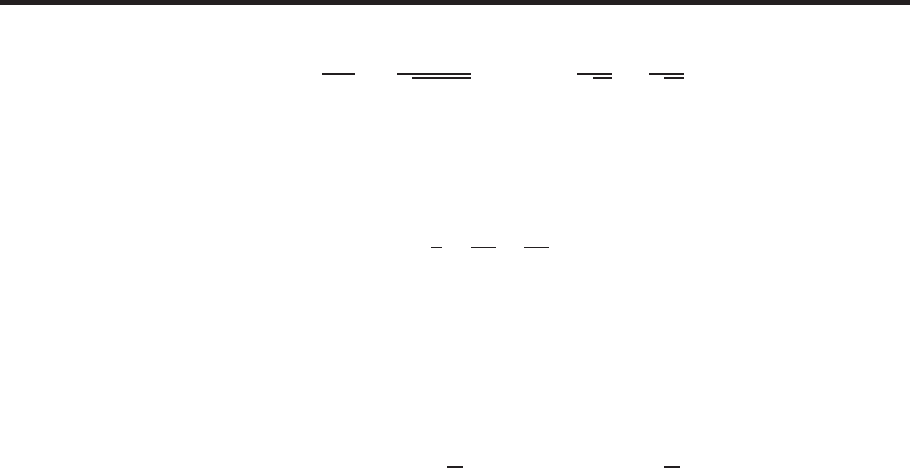
1226 Chapter Thirteen /SOLUTIONS
Problems
27. (a) Dividing ~v by its magnitude produces a unit vector ~u in the same direction as ~v :
~u =1
k~v k~v =1
√22+ 32(2
~
i+ 3~
j) = 2
√13
~
i+3
√13
~
j .
(b) Any vector ~w =a
~
i+b~
jsuch that ~v ·~w = 2a+ 3b= 0 is perpendicular to ~v . For example, ~w = 3
~
i−2~
jhas
this property, as do all scalar multiples of 3
~
i−2~
j.
28. (a) The plane can be written as 5x−2y−z+ 7 = 0, so the vector 5
~
i−2~
j−~
kis normal to the plane. The vector
λ
~
i+~
j+ 0.5~
kis parallel to 5
~
i−2~
j−~
kif one is a scalar multiple of the other. This occurs if the coefficients are
in proportion:
λ
5=1
−2=0.5
−1.
Solving gives λ=−2.5.
(b) Substituting x=a+ 1,y=a,z=a−1into the equation of the plane gives
a−1 = 5(a+ 1) −2a+ 7
a−1 = 5a+ 5 −2a+ 7
−13 = 2a
a=−6.5.
29. (a) On the x-axis, y=z= 0, so 5x= 21, giving x=21
5. So the only such point is (21
5,0,0).
(b) Other points are (0,−21,0), and (0,0,3). There are many other possible answers.
(c) ~n = 5
~
i−~
j+ 7~
k. It is the normal vector.
(d) The vector between two points in the plane is parallel to the plane. Using the points from part (b), the vector 3~
k−
(−21~
j) = 21~
j+ 3~
kis parallel to the plane.
30. (a) The vector ~n = 3
~
i−~
j−~
kis perpendicular to the plane since the plane can be written in the form (3
~
i−~
j−~
k)·
(x
~
i+y~
j+z~
k) = −2.
(b) Find two points in the plane by putting xand y-values into the equation and calculating the corresponding z-values.
If x= 1 and y= 0, then z= 2 + 3(1) −0 = 5, so the point (1,0,5) is on the plane. So is the point (0,1,1).
Therefore the vector (
~
i+ 5~
k)−(~
j+~
k) = ~
i−~
j+ 4~
kis parallel to the plane. (To check, we take the dot product
with ~n = 3
~
i−~
j−~
kand see if we get zero: (3
~
i−~
j−~
k)·(
~
i−~
j+ 4~
k) = 3 + 1 −4 = 0. Therefore~
i−~
j+ 4~
k
is parallel to the plane.)
31. (a) Writing the plane in the form 2x+ 3y−z= 0 shows that a normal vector is
~n = 2
~
i+ 3~
j−~
k .
Any multiple of this vector is also a correct answer.
(b) Any vector perpendicular to ~n is parallel to the plane, so one possible answer is
~v = 3
~
i−2~
j .
Many other answers are possible.
32. (a) goes with (I).
(b) goes with (III), (IV).
(c) goes with (II), (III).
(d) goes with (II).
33. (a) Perpendicular vectors have a dot product of 0. Since ~a ·~c = 1(−2) −3(−1) −1·1 = 0, and ~
b·~
d= 1(−1) +
1(−1) + 2 ·1 = 0, the pairs we want are ~a , ~c and ~
b , ~
d.
(b) Parallel vectors are multiples of one another, so there are no parallel vectors in this set.
(c) Since ~v ·~w =||~v ||||~w ||cos θ, the dot product of the vectors we want is positive. We have
~a ·~
b= 1 ·1−3·1−1·2 = −4
~a ·~
d= 1(−1) −3(−1) −1·1 = 1
~
b·~c = 1(−2) + 3(−1) + 2 ·1 = −1
~c ·~
d=−2(−1) −1(−1) + 1 ·1 = 4,
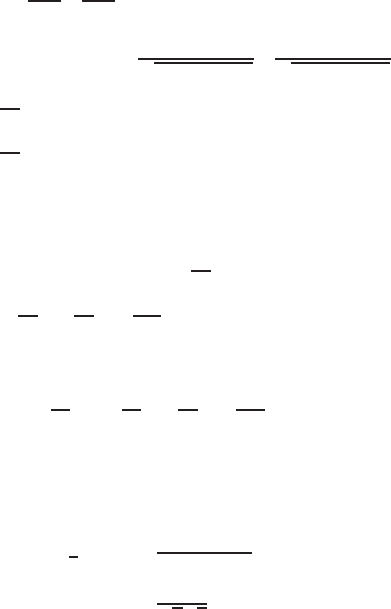
13.3 SOLUTIONS 1227
and we already know ~a ·~c =~
b·~
d= 0. Thus, the pairs of vectors with an angle of less than π/2between them are
~a , ~
dand ~c , ~
d.
(d) Vectors with an angle of more than π/2between them have a negative dot product, so pairs are ~a ,~
band ~
b ,~c .
34. Vectors ~v 1,~v 4, and ~v 8are all parallel to each other. Vectors ~v 3,~v 5, and ~v 7are all parallel to each other, and are all
perpendicular to the vectors in the previous sentence. Vectors ~v 2and ~v 9are perpendicular.
35. (a) Any multiple of ~v will work, for example, 8
~
i+ 6~
j.
(b) Any vector ~w such that ~v ·~w = 0 will work, such as −3
~
i+ 4~
j.
36. In general, ~u and ~v are perpendicular when ~u ·~v = 0.
In this case, ~u ·~v = (t
~
i−~
j+~
k)·(t
~
i+t~
j−2~
k) = t2−t−2.
This is zero when t2−t−2 = 0, i.e. when (t−2)(t+ 1) = 0, so t= 2 or −1.
In general, ~u and ~v are parallel if and only if ~v =α~u for some real number α.
Thus we need αt
~
i−α~
j+α~
k=t
~
i+t~
j−2~
k, so we need αt =t, and −α=t, and α=−2. But if α=−2, we
can’t have αt =tunless t= 0, and if t= 0, we can’t have −α=t, so there are no values of tfor which ~u and ~v are
parallel.
37. (a) Increasing ||~v || increases ~v ·~w because ~v ·~w =||~v ||||~w ||cos θ, and cos θis positive.
(b) Increasing θdecreases ~v ·~w because cos θis a decreasing function.
38. Let
~a =~a parallel +~a perp
where ~a parallel is parallel to ~
d, and ~a perp is perpendicular to ~
d. Then ~a parallel is the projection of ~a in the direction of
~
d:
~a parallel =~a ·~
d
k~
dk~
d
k~
dk
=(3
~
i+ 2~
j−6~
k)·(2
~
i−4~
j+~
k)
√22+ 42+ 12(2
~
i−4~
j+~
k)
√22+ 42+ 12
=−8
21 (2
~
i−4~
j+~
k)
=−8
21 ~
d
Since we now know ~a and ~a parallel, we can solve for ~a perp:
~a perp =~a −~a parallel
= (3
~
i+ 2~
j−6~
k)−−8
21 (2
~
i−4~
j+~
k)
=79
21~
i+10
21~
j−118
21 ~
k .
Thus we can now write ~a as the sum of two vectors, one parallel to ~
d, the other perpendicular to ~
d:
~a =−8
21 ~
d+79
21~
i+10
21~
j−118
21 ~
k
39. We first find displacement vectors −→
AB = (4 −2)
~
i+ (2 −2)~
j+ (1 −2)~
k= 2
~
i−~
kand −→
AC = (2 −2)
~
i+ (3 −2)~
j+
(1 −2)~
k=~
j−~
k. Then
cos(6BAC) = −→
AB ·−→
AC
k−→
ABkk−→
ACk
=1
√5√2
= 0.3162.
Thus angle BAC is 71.57◦(or 1.25 radians.)

1228 Chapter Thirteen /SOLUTIONS
40. If P= (5,0,0),Q= (0,−3,0),R= (0,0,2), then vectors along the three sides of the triangle are
−−→
QP = (5 −0)
~
i+ (0 −(−3))~
j= 5
~
i+ 3~
j
−→
RP = (5 −0)
~
i+ (0 −2)~
k= 5
~
i−2~
k
−→
QR = (0 −(−3))~
j+ (2 −0)~
k= 3~
j+ 2~
k
Thus, the lengths of the sides of the triangle are
k−−→
QP k=k5
~
i+ 3~
jk=√25 + 9 = √34
k−→
RP k=k5
~
i−2~
kk=√25 + 4 = √29
k−→
QRk=k3~
j+ 2~
kk=√9 + 4 = √13.
The angle between the vectors ~v and ~w is given by
cos θ=~v ·~w
k~v kk~w kso θ= arccos ~v ·~w
k~v kk~w k.
Thus,
Angle at P= arccos −−→
QP·−→
RP
k−−→
QP kk−→
RP k
= arccos (5
~
i+ 3~
j)·(5
~
i−2~
k)
√34√29
= arccos 25
√34√29
= 37.235◦.
Angle at Q= arccos −−→
QP·−→
QR
k−−→
QP kk−→
QRk
= arccos (5
~
i+ 3~
j)·(3~
j+ 2~
k)
√34√13
= arccos 9
√34√13
= 64.654◦.
Now we use the fact that the angles must add up to 180◦. Thus
Angle at R= 180◦−(37.235◦+ 64.654◦) = 78.111◦.
41. (a) The points A,Band Care shown in Figure 13.27.
xy
z
B
C
A
Figure 13.27
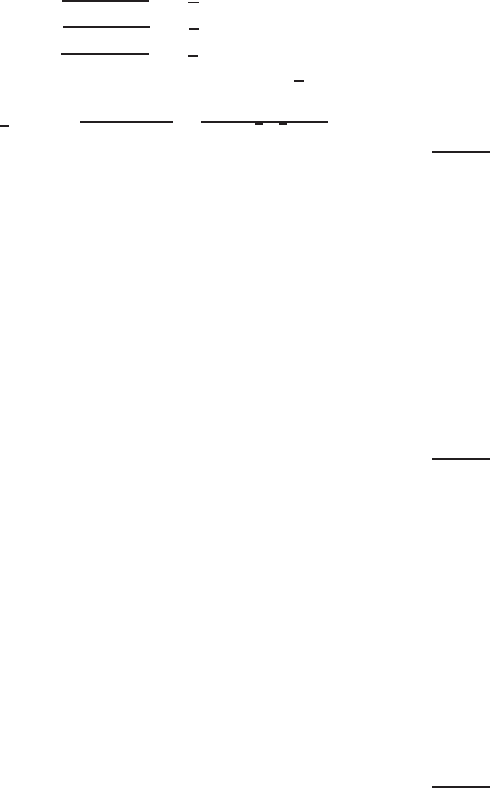
13.3 SOLUTIONS 1229
First, we calculate the vectors which form the sides of this triangle:
−→
AB = (4
~
i+ 2~
j+~
k)−(2
~
i+ 2~
j+ 2~
k) = 2
~
i−~
k
−−→
BC = (2
~
i+ 3~
j+~
k)−(4
~
i+ 2~
j+~
k) = −2
~
i+~
j
−→
AC = (2
~
i+ 3~
j+~
k)−(2
~
i+ 2~
j+ 2~
k) = ~
j−~
k
Now we calculate the lengths of each of the sides of the triangles:
k−→
ABk=p22+ (−1)2=√5
k−−→
BCk=p(−2)2+ 12=√5
k−→
ACk=p12+ (−1)2=√2
Thus the length of the shortest side of Sis √2.
(b) cos 6BAC =−→
AB·−→
AC
k−→
ABk·k−→
ACk
=2·0+0·1+(−1)·(−1)
√5·√2≈0.32
42. (a) We first find the unit vector in direction ~v . Since ||~v || =√32+ 42= 5, the unit vector in direction of ~v is
~u = 0.6
~
i+ 0.8~
j. Then
~
Fparallel = ( ~
F·~u )~u
= (4 ·0.6 + 1 ·0.8)~u
= 3.2~u
= 1.92
~
i+ 2.56~
j .
(b) We have
~
Fperp =~
F−~
Fparallel = (4
~
i+~
j)−(1.92
~
i+ 2.56~
j) = 2.08
~
i−1.56~
j .
(c) Since work is the dot product of the force and displacement vectors, we have
W=~
F·~v = 4 ·3 + 1 ·4 = 16.
43. (a) We first find the unit vector in direction ~v . Since ||~v || =√32+ 42= 5, the unit vector in direction of ~v is
~u = 0.6
~
i+ 0.8~
j. Then
~
Fparallel = ( ~
F·~u )~u
= (0.2·0.6−0.5·0.8)~u
=−0.28~u
=−0.168
~
i−0.224~
j .
(b) We have
~
Fperp =~
F−~
Fparallel = (0.2
~
i−0.5~
j)−(−0.168
~
i−0.224~
j) = 0.368
~
i−0.276~
j .
(c) Since work is the dot product of the force and displacement vectors, we have
W=~
F·~v = 0.2·3−0.5·4 = −1.4.
44. (a) We first find the unit vector in direction ~v . Since ||~v || =√32+ 42= 5, the unit vector in direction of ~v is
~u = 0.6
~
i+ 0.8~
j. Then
~
Fparallel = ( ~
F·~u )~u
= (9 ·0.6 + 12 ·0.8)~u
= 15~u
= 9
~
i+ 12~
j .
Notice that the component of ~
Fin direction ~v is equal to ~
F. This makes sense (and could have been predicted)
since ~
Fis parallel to ~v .
(b) We have
~
Fperp =~
F−~
Fparallel =~
0.
(c) Since work is the dot product of the force and displacement vectors, we have
W=~
F·~v = 9 ·3 + 12 ·4 = 75.

1230 Chapter Thirteen /SOLUTIONS
45. (a) We first find the unit vector in direction ~v . Since ||~v || =√32+ 42= 5, the unit vector in direction of ~v is
~u = 0.6
~
i+ 0.8~
j. Then
~
Fparallel = ( ~
F·~u )~u
= (−0.4·0.6 + 0.3·0.8)~u
=~
0.
Notice that the component of ~
Fin direction ~v is equal to ~
0. This makes sense (and could have been predicted) since
~
Fis perpendicular to ~v .
(b) We have
~
Fperp =~
F−~
Fparallel =~
F .
(c) Since work is the dot product of the force and displacement vectors, we have
W=~
F·~v =−0.4·3 + 0.3·4 = 0.
Notice that since the force is perpendicular to the displacement, the work done is zero.
46. (a) We first find the unit vector in direction ~v . Since ||~v || =√32+ 42= 5, the unit vector in direction of ~v is
~u = 0.6
~
i+ 0.8~
j. Then
~
Fparallel = ( ~
F·~u )~u
= (−3·0.6−5·0.8)~u
=−5.8~u
=−3.48
~
i−4.64~
j .
(b) We have
~
Fperp =~
F−~
Fparallel = (−3
~
i−5~
j)−(−3.48
~
i−4.64~
j) = 0.48
~
i−0.36~
j .
(c) Since work is the dot product of the force and displacement vectors, we have
W=~
F·~v =−3·3−5·4 = −29.
47. (a) We first find the unit vector in direction ~v . Since ||~v || =√32+ 42= 5, the unit vector in direction of ~v is
~u = 0.6
~
i+ 0.8~
j. Then
~
Fparallel = ( ~
F·~u )~u
= (−6·0.6−8·0.8)~u
=−10~u
=−6
~
i−8~
j
=~
F .
Notice that ~
Fis in the opposite direction from ~v so it makes sense (and could have been predicted) that ~
Fparallel =
~
F.
(b) We have ~
Fperp =~
F−~
Fparallel =~
0.
(c) Since work is the dot product of the force and displacement vectors, we have
W=~
F·~v =−6·3−8·4 = −50.
48. (a) We first find the unit vector in direction ~v . Since ||~v || =√22+ 32=√13, the unit vector in direction of ~v is
~u =~v /√13. Then
~
Fparallel = ( ~
F·~u )~u
= (−60/√13)~u
=−120
13 ~
i+−180
13 ~
j
=−9.231
~
i−13.846~
j .
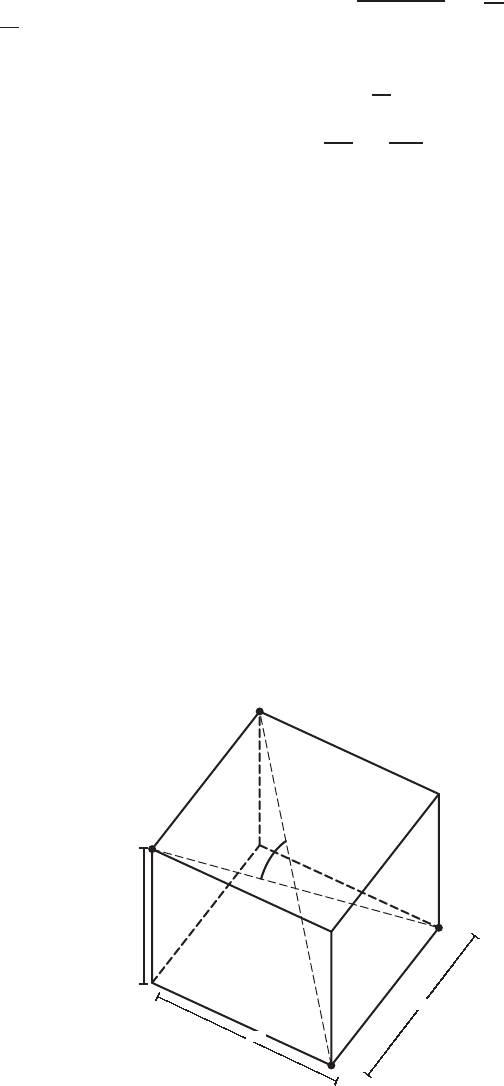
13.3 SOLUTIONS 1231
(b) We have
~
Fperp =~
F−~
Fparallel = (−20~
j)−(−9.231
~
i−13.846~
j) = 9.231
~
i−6.154~
j).
(c) Since work is the dot product of the force and displacement vectors, we have
W=~
F·~v =−60.
49. (a) We first find the unit vector in direction ~v . Since ||~v || =p52+ (−1)2=√26, the unit vector in direction of ~v is
~u =~v /√26. Then
~
Fparallel = ( ~
F·~u )~u
= (20/√26)~u
=100
26 ~
i+−20
26 ~
j
= 3.846
~
i−0.769~
j .
(b) We have ~
Fperp =~
F−~
Fparallel = (−20~
j)−(3.846
~
i−0.769~
j) = −3.846
~
i−19.231~
j .
(c) Since work is the dot product of the force and displacement vectors, we have
W=~
F·~v = 20.
50. (a) Notice that ~v is parallel to ~
F(although in the opposite direction.) Therefore, ~
Fparallel =~
F.
(b) We have ~
Fperp =~
F−~
Fparallel =~
0.
(c) Since work is the dot product of the force and displacement vectors, we have
W=~
F·~v =−60.
51. (a) Notice that ~v is perpendicular to ~
F. Therefore, ~
Fparallel =~
0.
(b) We have ~
Fperp =~
F−~
Fparallel =~
F .
(c) Since work is the dot product of the force and displacement vectors, we have
W=~
F·~v = 0.
The work is zero since the direction of the force is perpendicular to the direction of the displacement.
52. Let the room be put in the coordinate system as shown in Figure 13.28.
0 = (0,0,0)
A= (0,0,25)
B= (0,80,25)
C= (200,0,0)
D= (200,80,0)
θ
✛
✛
✛
✛
✛
✛
80
25
200
Figure 13.28
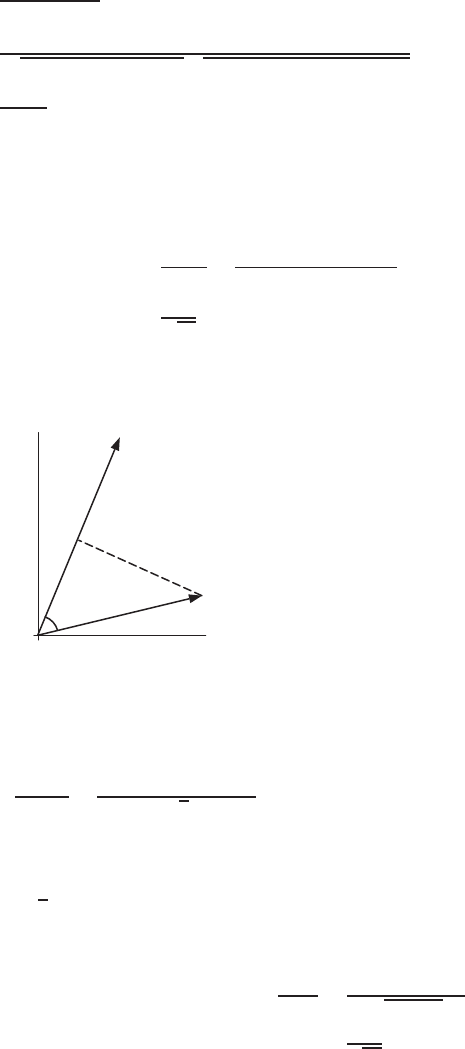
1232 Chapter Thirteen /SOLUTIONS
Then the vectors of the two strings are given by:
−−→
AD = (200
~
i+ 80~
j+ 0~
k)−(0
~
i+ 0~
j+ 25~
k) = 200
~
i+ 80~
j−25~
k
−−→
BC = (200
~
i+ 0~
j+ 0~
k)−(0
~
i+ 80~
j+ 25~
k) = 200
~
i−80~
j−25~
k.
Let the angle between −−→
AD and −−→
BC be θ. Then we have
cos θ=−−→
AD ·−−→
BC
k−−→
ADkk−−→
BCk
=200(200) + (80)(−80) + (−25)(−25)
p2002+ 802+ (−25)2p(200)2+ (−80)2+ (−25)2
=34225
47025
= 0.727804
53. We need to find the speed of the wind in the direction of the track. Looking at Figure 13.29, we see that we want the
component of ~w in the direction of ~v . We calculate
k~w parallelk=k~w kcos θ=~w ·~v
k~v k=(5
~
i+~
j)·(2
~
i+ 6~
j)
k2
~
i+ 6~
jk
=16
√40 ≈2.53
<5
Therefore, the race results will not be disqualified.
x
y
Track
~v = 2
~
i+ 6~
j
θ
Wind
~w = 5
~
i+~
j
0
Figure 13.29
54. We find the component of the wind ~w in the direction of the airplane. A direction vector for the airplane is ~v =~
i−~
j.
The component of ~w 1in the direction of ~v is given by
~w 1·~v
k~v k=−4·1 + (−1) ·(−1)
√2=−2.12.
Similarly, we find the component for each wind vector in the direction of the airplane. We see that, in the direction of the
airplane, the component of ~w 1is −2.12, of ~w 2is 2.12, of ~w 3is −6.36, of ~w 4is 5.66, and of ~w 5is 4.95. The vector
~w 4increases the plane’s speed the most and the vector ~w 3slows the plane down the most.
55. (a) The speed of the current is k~c k=√5 = 2.24 m/sec.
(b) The speed of the current in the direction of the canoe’s motion is the component of ~c in the direction of ~v . This is
given by:
Speed of current in direction of canoe’s motion =~c ·~v
k~v k=(1)(5) + (2)(3)
√52+ 32
=11
√34
= 1.89 m/sec.
Notice that the speed of the current in the direction of the canoe is less than the speed of the current in the direction
in which the current is moving.
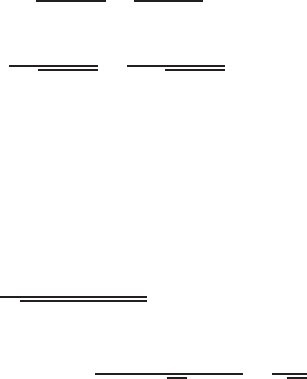
13.3 SOLUTIONS 1233
56. Let ~u = 3
~
i+ 4~
jand ~v = 5
~
i−12~
j. We seek a vector ~w =x
~
i+y~
jsuch that the cosine of the angle between ~u and
~w equals the cosine of the angle between ~v and ~w . Thus
~u ·~w
k~u kk~w k=~v ·~w
k~v kk~w k
or 3x+ 4y
5px2+y2=5x−12y
13px2+y2.
Simplifying, we have x=−8y. The vector we want is of the form ~w =−8y~
i+y~
j, but should we take y > 0or y < 0?
The smaller of the two angles formed by ~u and ~v is between 0◦and 1800, and so ~w must make an acute angle with ~u
and ~v . If y > 0then ~u ·~w =−20y < 0indicating an obtuse angle and if y < 0then ~u ·~w =−20y > 0indicating an
acute angle. We have ~w =−8y~
i+y~
jwith y < 0. Thus ~w can be any positive multiple of the vector 8
~
i−~
j.
57. The planes are parallel, with normal vectors ~n = 2
~
i−5~
j+~
k . Pick any point on 2x−5y+z= 10,say (5,0,0), and
any point on z= 5y−2x, say (0,0,0). The vector between them is ~
d= 5
~
i, so we want to find the magnitude of the
component of ~
din the direction of ~n . A unit vector in the direction of ~n is
~v =1
p22+ (−5)2+ 122
~
i−5~
j+~
k,
so
Distance =|~
d·~v |=5
~
i·(2
~
i−5~
j+~
k)
√30 =10
√30 .
58. We have
~p ·~q = (1.00)(43) + (3.50)(57) + (4.00)(12) + (2.75)(78) + (5.00)(20) + (3.00)(35)
= 710 dollars.
The vendor took in $710 in from sales. The quantity ~p ·~q represents the total revenue earned.
59. The vector ~a represents the averages of the exams, written as decimals. The vector ~w represents the weightings.
~w ·~a = 0.1·0.75 + 0.15 ·0.91 + 0.25 ·0.84 + 0.5·0.87 = 0.8565 = 85.65%
The dot product, 86.65%, represents the class average of the four exams in the course.
60. If ~x and ~y are two consumption vectors corresponding to points satisfying the same budget constraint, then
~p ·~x =k=~p ·~y .
Therefore we have
~p ·(~x −~y ) = ~p ·~x −~p ·~y = 0.
Thus ~p and ~x −~y are perpendicular; that is, the difference between two consumption vectors on the same budget
constraint is perpendicular to the price vector.
61. Property 2 says that multiplying one of the vectors by a scalar simply multiplies the dot product by the same scalar. If
λ > 0, then when one vector is multiplied by λ, the angle between the vectors does not change, but the length of one
vector, and hence the dot product, is multiplied by λ. The result remains true when λ < 0. For a justification in the case
when λ < 0, see Problem 67 on page 1235.
62. We want to show that (~
b·~c )~a −(~a ·~c )~
band ~c are perpendicular. We do this by taking their dot product:
((~
b·~c )~a −(~a ·~c )~
b)·~c = (~
b·~c )(~a ·~c )−(~a ·~c )(~
b·~c ) = 0.
Since the dot product is 0, the vectors (~
b·~c )~a −(~a ·~c )~
band ~c are perpendicular.
63. Suppose ~v =v1
~
i+v2~
j+v3~
kand ~w =w1
~
i+w2~
j+w3~
k.
•Property 1:
We calculate both ~v ·~w and ~w ·~v using the algebraic definition of the dot product:
~v ·~w =v1w1+v2w2+v3w3
~w ·~v =w1v1+w2v2+w3v3
But since ordinary multiplication of scalars is commutative, v1w1=w1v1and so on. Therefore
~v ·~w =~w ·~v .

1234 Chapter Thirteen /SOLUTIONS
•Property 2:
First we observe that
λ ~w =λ(w1
~
i+w2~
j+w3~
k) = (λw1)
~
i+ (λw2)~
j+ (λw3)~
k
λ~v =λ(v1
~
i+v2~
j+v3~
k) = (λv1)
~
i+ (λv2)~
j+ (λv3)~
k .
Now we calculate the three quantities ~v ·(λ ~w )and λ(~v ·~w )and (λ~v )·~w
~v ·(λ ~w ) = v1(λw1) + v2(λw2) + v3(λw3)
λ(~v ·~w ) = λ(v1w1+v2w2+v3w3)
(λ~v )·~w = (λv1)w1+ (λv2)w2+ (λv3)w3
Since ordinary multiplication is associative and commutative, we know that
v1(λw1) = λv1w1= (λv1)w1and so on. Thus, we have ~v ·(λ ~w ) = (λ~v )·~w .
In addition, the distributive property of ordinary multiplication tells us that
λ(v1w1+v2w2+v3w3) = λv1w1+λv2w2+λv3w3
Thus, we know that all three quantities are equal
~v ·(λ ~w ) = λ(~v ·~w ) = (λ~v )·~w
•Property 3:
First we observe that
~v +~w = (v1+w1)
~
i+ (v2+w2)~
j+ (v3+w3)~
k .
Next we calculate the quantities ((~v +~w )·~u )and (~v ·~u +~w ·~u ).
(~v +~w )·~u = (v1+w1)u1+ (v2+w2)u2+ (v3+w3)u3
~v ·~u +~w ·~u = (v1u1+v2u2+v3u3) + (w1u1+w2u2+w3u3).
The distributive law of ordinary multiplication shows that (v1+w1)u1=v1u1+w1u1, and so on. Thus, the dot
product is distributive also:
(~v +~w )·~u =~v ·~u +~w ·~u
64. Since ~u ·~w =~v ·~w ,(~u −~v )·~w = 0. This equality holds for any ~w , so we can take ~w =~u −~v . This gives
k~u −~v k2= (~u −~v )·(~u −~v ) = 0,
that is,
k~u −~v k= 0.
This implies ~u −~v = 0, that is, ~u =~v .
65. Since the dot product of a vector with itself is the square of the vector’s magnitude, we can check that two vectors have
the same magnitude by computing dot products. We have
~u
k~u k2−~v
k~v k2·~u
k~u k2−~v
k~v k2=~u ·~u
k~u k4−~u ·~v +~v ·~u
k~u k2k~v k2+~v ·~v
k~v k4
=1
k~u k2−2~u ·~v
k~u k2k~v k2+1
k~v k2.
and
~u
k~u kk~v k−~v
k~u kk~v k·~u
k~u kk~v k−~v
k~u kk~v k=~u ·~u
k~u k2k~v k2−~u ·~v +~v ·~u
k~u k2k~v k2+~v ·~v
k~u k2k~v k2
=1
k~v k2−2~u ·~v
k~u k2k~v k2+1
k~u k2
The two dot products are equal, which shows that the vectors ~u /k~u k2−~v /k~v k2and ~u /(k~u kk~v k)−~v /(k~u kk~v k)
have the same magnitude.
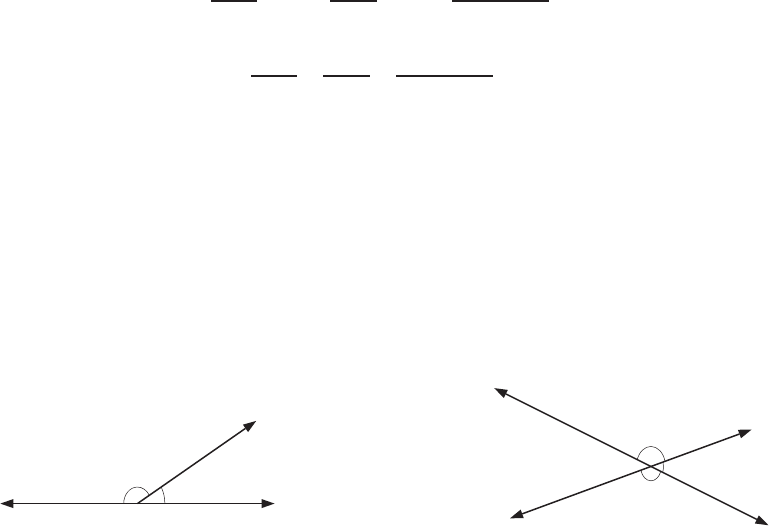
13.3 SOLUTIONS 1235
66. If ~u =~
0, then both sides of the equation are zero. If ~u 6=~
0, write ~v parallel ,~w parallel, and (~v +~w )parallel for the
components of ~v ,~w , and ~v +~w in the direction of ~u . Then Figure 13.34 shows that
~v parallel +~w parallel = (~v +~w )parallel.
So ~v ·~
u
k~u k2~u +~w ·~u
k~u k2~u =(~v +~w )·~u
k~u k2~u .
Thus, since ~u 6=~
0, we deduce that
~v ·~u
k~u k2+~w ·~u
k~u k2−(~v +~w )·~u
k~u k2= 0,
so
~v ·~u +~w ·~u = (~v +~w )·~u .
67. Suppose θis the angle between ~u and ~v .
(a) By the definition of scalar multiplication, we know that −~v is in the opposite direction of ~v , so the angle between ~u
and −~v is π−θ. (See Figure 13.30.) Hence,
~u ·(−~v ) = k~u kk −~v kcos(π−θ)
=k~u kk~v k(−cos θ)
=−(~u ·~v )
−~v ~v
θ
π−θ
~u
Figure 13.30
λ~v
λ~u
λ < 0
~u
~v
θ
π−θ
π−θ
Figure 13.31
(b) If λ < 0, the angle between ~u and λ~v is π−θ, and so is the angle between λ~u and ~v . (See Figure 13.31.) So we
have,
~u ·(λ~v ) = k~u kkλ~v kcos(π−θ)
=|λ|k~u kk~v k(−cos θ)
=−λk~u kk~v k(−cos θ)since |λ|=−λ
=λk~u kk~v kcos θ
=λ(~u ·~v )
By a similar argument, we have
(λ~u )·~v =kλ~u kk~v kcos(π−θ)
=−λk~u kk~v k(−cos θ)
=λ(~u ·~v )
68. Let ~u and ~v be the displacement vectors from Cto the other two vertices. Then
c2=k~u −~v k2
= (~u −~v )·(~u −~v )
=~u ·~u −~v ·~u −~u ·~v +~v ·~v
=k~u k2−2kukkvkcos C+k~v k2
=a2−2ab cos C+b2

1236 Chapter Thirteen /SOLUTIONS
69. We substitute ~u =u1
~
i+u2~
j+u3~
kand by the result of Problem 66, we expand as follows:
(~u ·~v )geom = (u1
~
i+u2~
j+u3~
k)·~v
= (u1
~
i)·~v + (u2~
j)·~v + (u3~
k)·~v
where all the dot products are defined geometrically By the result of Problem 67 we can write
(~u ·~v )geom =u1(
~
i·~v )geom +u2(~
j·~v )geom +u3(~
k·~v )geom.
Now substitute ~v =v1
~
i+v2~
j+v3~
kand expand, again using Problem 66 and the geometric definition of the dot
product:
(~u ·~v )geom =u1~
i·(v1
~
i+v2~
j+v3~
k)geom
+u2~
j·(v1
~
i+v2~
j+v3~
k)geom
+u3~
k·(v1
~
i+v2~
j+v3~
k)geom
=u1v1(
~
i·~
i)geom +u1v2(
~
i·~
j)geom +u1v3(
~
i·~
k)geom
+u2v1(
~
i·~
i)geom +u2v2(
~
i·~
j)geom +u2v3(
~
i·~
k)geom
+u3v1(
~
i·~
i)geom +u3v2(
~
i·~
j)geom +u3v3(
~
i·~
k)geom
The geometric definition of the dot product shows that
~
i·~
i=k~
ikk~
ikcos 0 = 1
~
i·~
j=k~
ikk~
jkcos π
2= 0.
Similarly ~
j·~
j=~
k·~
k= 1 and~
i·~
k=~
j·~
k= 0. Thus, the expression for (~u ·~v )geom becomes
(~u ·~v )geom =u1v1(1) + u1v2(0) + u1v3(0)
+u2v1(0) + u2v2(1) + u2v3(0)
+u3v1(0) + u3v2(0) + u3v3(1)
=u1v1+u2v2+u3v3.
70. (a) Since q(t) = (~v +t ~w )·(~v +t ~w ) = k~v +t ~w k2and since the length of any vector is nonnegative, we must have
q(t) = k~v +t ~w k2≥0
for all real t.
(b) Using the distributive law
q(t) = (~v +t ~w )·(~v +t ~w ) = ~v ·~v +t ~w ·~v +~v ·t ~w +t2~w ·~w
=k~v k2+ 2(~v ·~w )t+k~w k2t2.
If ~w 6= 0, then k~w k 6= 0 and q(t)is quadratic in t.
(c) Since q(t)≥0, the quadratic has one repeated root or no roots, so the discriminant must be less than or equal to zero.
Thus,
(2~v ·~w )2−4k~v k2k~w k2≤0.
Taking square roots, we have
|~v ·~w | ≤ k~v kk~w k.
If ~w = 0, then q(t)is no longer a quadratic. However, in that case,
|~v ·~w |= 0 = k~v kk~w k
so the inequality still holds.
Strengthen Your Understanding
71. The expression (~u ·~v )·~w does not make sense. You cannot take the dot product of the scalar ~u ·~v and the vector ~w .

13.4 SOLUTIONS 1237
72. The formula ~v parallel = (~u ·~v )~u works only when ~u is a unit vector. We can see that ~v parallel 6= 3(
~
i+~
j)because
~v perp =~v −~v parallel = (2
~
i+~
j)−(3
~
i+ 3~
j) = −~
i−2~
j ,
which is not perpendicular to ~u =~
i+~
j.
73. Given an equation for a plane, to find the normal vector, we put x, y, z all on the same side of the equation. This gives
2x+ 3y−z= 0. Then a normal vector is 2
~
i+ 3~
j−~
k.
74. The displacement vector from (1,1) to (a, b)is (a−1)
~
i+ (b−1)~
j, so we want
((a−1)
~
i+ (b−1)~
j)·(
~
i+ 2~
j) = (a−1) + 2(b−1) = a+ 2b−3 = 0.
For example, if b= 3, then a= 3 −2(3) = −3. In general, any (a, b)with a= 3 −2bis a possible example.
75. A plane perpendicular to~
i+ 2~
j+ 3~
kis x+ 2y+ 3z= 0. Solving for z, we get z= (−1/3)x+ (−2/3)y, so we can
let f(x, y) = (−1/3)x+ (−2/3)y.
76. False. The dot product is a scalar.
77. True. Components of a normal vector can be read directly from coefficients of x, y and zin the equation for a plane.
78. True. The cosine of the angle between the vectors is negative when the angle is between π/2and π.
79. False. The equation z=x+yhas normal ~
i+~
j−~
k, which is not parallel to ~
i+~
j+~
k. An equation satisfying the
given conditions is x+y+z= 6.
80. True. The vector from (0,1,0) to (1,1,0) is~
i, while the vector from (0,1,0) to (0,1,1) is ~
k, and~
i·~
k= 0.
81. True. ~v ·~v =k~v k2, which cannot be negative.
82. False. If the vectors are nonzero and perpendicular, the dot product will be zero (e.g.~
i·~
j= 0).
83. False. If ~v and ~w are different vectors, but both are perpendicular to ~u , then both ~u ·~v and ~u ·~w are zero, yet ~v 6=~w .
For example, take ~u =~
i,~v =~
jand ~w =~
k.
84. True. Using the distributive property, and the fact that ~u ·(−~v ) = −~u ·~v , we have
(~u +~v )·(~u −~v ) = ~u ·~u +~u ·(−~v ) + ~v ·~u −~v ·~v =k~u k2− k~v k2.
85. True. This vector is ~v Perp, the component of ~
vperpendicular to the unit vector ~u . To check, calculate the dot product
~u ·(~v −(~v ·~u )~u ) = ~u ·~v −(~v ·~u )(~u ·~u ) = ~u ·~v −~v ·~u = 0,
since ~u ·~u =k~u k2= 1.
Solutions for Section 13.4
Exercises
1. ~v ×~w =~
k×~
j=−~
i(remember~
i ,~
j ,~
kare unit vectors along the axes, and you must use the right hand rule.)
2. ~v =−~
i, and ~w =~
j+~
k
~v ×~w =
~
i~
j~
k
−10 0
0 1 1
=~
j−~
k
3. ~v =~
i+~
k, and ~w =~
i+~
j
~v ×~w =
~
i~
j~
k
10 1
1 1 0
=−~
i+~
j+~
k
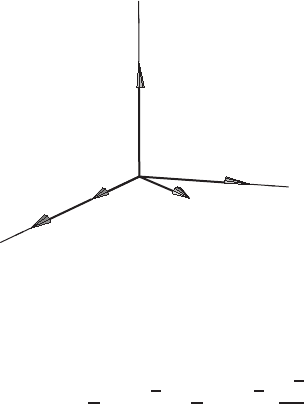
1238 Chapter Thirteen /SOLUTIONS
4. ~v =~
i+~
j+~
k, and ~w =~
i+~
j−~
k
~v ×~w =
~
i~
j~
k
1 1 1
1 1 −1
=−2
~
i+2~
j
5. ~v = 2
~
i−3~
j+~
k, and ~w =~
i+ 2~
j−~
k
~v ×~w =
~
i~
j~
k
2−3 1
1 2 −1
=~
i+3~
j+ 7~
k
6. ~v = 2
~
i−~
j−~
k, and ~w =−6
~
i+ 3~
j+ 3~
k
~v ×~w =
~
i~
j~
k
2−1−1
−63 3
= 0
~
i+ 0~
j+ 0~
k=~
0.
7. Since ~v =−3
~
i+ 5~
j+ 4~
kand ~w =~
i−3~
j−~
k,
~v ×~w =
~
i~
j~
k
−35 4
1−3−1
= (5(−1) −4(−3))
~
i−((−3)(−1) −4(1))~
j+ ((−3)(−3) −5(1))~
k
= (−5 + 12)
~
i−(3 −4)~
j+ (9 −5)~
k
= 7
~
i+~
j+ 4~
k .
8.
x
y
z
2
~
i
~
i
~
k
~
j
~
i+~
j
Figure 13.32
By the definition of cross product, 2
~
i×(
~
i+~
j)is in the direction of ~
k. The magnitude of it equals to the area of
the parallelogram which is
k2
~
ik · k~
i+~
jksin π
4= 2√2 sin π
4= 2√2·√2
2= 2.
So 2
~
i×(
~
i+~
j) = 2~
k . See Figure 13.32.
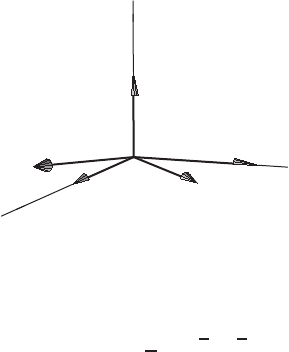
13.4 SOLUTIONS 1239
9.
x
z
y
~
i
~
i−~
j
~
k
~
j
~
i+~
j
Figure 13.33
By definition, (
~
i+~
j)×(
~
i−~
j)is in the direction of −~
k. The magnitude is
k~
i+~
jk · k~
i−~
jksin π
2=√2·√2·1 = 2.
So (
~
i+~
j)×(
~
i−~
j) = −2~
k . See Figure 13.33.
10.
[(
~
i+~
j)×~
i]×~
j= (
~
i×~
i+~
j×~
i)×~
j
= (~
0−~
k)×~
j
=−~
k×~
j
=~
j×~
k=~
i .
11.
(
~
i+~
j)×(
~
i×~
j) = (
~
i+~
j)×~
k
= (
~
i×~
k) + (~
j×~
k)
=−~
j+~
i=~
i−~
j .
12.
~a ×~
b=
~
i~
j~
k
31−1
1−4 2
=
1−1
−42
~
i−
3−1
1 2
~
j+
3 1
1−4
~
k
=−2
~
i−7~
j−13~
k .
Since
~a ·(~a ×~
b) = 3(−2) + (−7) −(−13) = 0
and ~
b·(~a ×~
b) = 1(−2) −4(−7) + 2(−13) = 0,
~a ×~
bis perpendicular to both ~a and ~
b.
13. We find that ~v ×~w =−6
~
i+ 7~
j+ 8~
kand ~w ×~v = 6
~
i−7~
j−8~
k. Notice that
~v ×~w =−(~w ×~v ).

1240 Chapter Thirteen /SOLUTIONS
14. We can form the displacement vectors ~a =−~
i+~
j+ 0~
kfrom (1,0,0) to (0,1,0) and~
b=−~
i+ 0~
j+~
kfrom (1,0,0)
to (0,0,1). A normal vector to the plane is ~a ×~
b=~
i+~
j+~
k. Using the point (1,0,0), the plane can be written as
(x−1) + y+z= 0 or x+y+z= 1.
15. The displacement vector from (3,4,2) to (−2,1,0) is:
~a =−5
~
i−3~
j−2~
k .
The displacement vector from (3,4,2) to (0,2,1) is:
~
b=−3
~
i−2~
j−~
k .
Therefore the vector normal to the plane is:
~n =~a ×~
b=−~
i+~
j+~
k .
Using the first point, the equation of the plane can be written as:
−(x−3) + (y−4) + (z−2) = 0.
The equation of the plane is thus:
−x+y+z= 3.
16. We first calculate the cross product:
~
b×~c =
~
i~
j~
k
54 3
1 1 1
= (4 −3)
~
i−(5 −3)~
j+ (5 −4)~
k=~
i−~
j+~
k .
Then
Volume =|(~
b×~c )·~a |=|(
~
i−~
j+~
k)·(3
~
i+ 4~
k+ 5
~
)|=|3−4 + 5|= 4.
17. We first calculate the cross product:
~
b×~c =
~
i~
j~
k
1−11
1 1 −1
= (1 −1)
~
i−(−1−1)~
j+ (1 + 1)~
k= 0
~
i+ 2~
j+ 2~
k .
Then
Volume =|(~
b×~c )·~a |=|(0
~
i+ 2~
j+ 2~
k)·(−~
i+~
k+~
k)|=|0 + 2 + 2|= 4.
18. We first calculate the cross product:
~
b×~c =
~
i~
j~
k
02 9
0 0 3
= (6 −0)
~
i−(0 −0)~
j+ (0 + 0)~
k= 6
~
i .
Then
Volume =|(~
b×~c )·~a |=|(6
~
i)·(
~
i+ 8~
j+ 7~
k)|=|6 + 0 + 0|= 6.
19. We first calculate the cross product:
~
b×~c =
~
i~
j~
k
10 1
0 1 1
= (0 −1)
~
i−(1 −0)~
j+ (1 −0)~
k=−~
i−~
j+~
k .
Then
Volume =|(~
b×~c )·~a |=|(−~
i−~
j+~
k)·(
~
i+~
k+ 2~
k)|=| − 1−1 + 2|= 0.
The volume is zero because ~a =~
b+~c , so the three vectors lie in a plane; they do not make a 3-dimensional parallelepiped
Problems
20. Normal vectors of the planes are ~n 1= 2
~
i−3~
j+ 5~
kand ~n 2= 4
~
i+~
j−3~
krespectively. The line of intersection is
perpendicular to both normals. (Picture the pages in a partially open book.) We can use ~n 1×~n 2= 4
~
i+ 26~
j+ 14~
k.
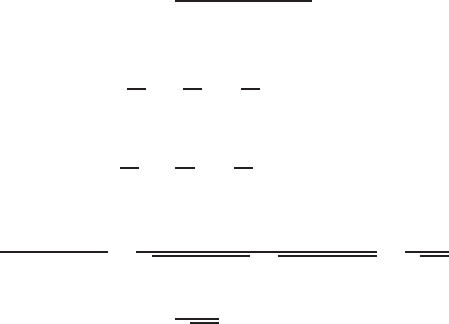
13.4 SOLUTIONS 1241
21. We use the same normal ~n = 4
~
i+ 26~
j+ 14~
kand the point (0,0,0) to get 4(x−0) + 26(y−0) + 14(z−0) = 0, or
4x+ 26y+ 14z= 0.
22. We use the same normal ~n = 4
~
i+ 26~
j+ 14~
kand the point (4,5,6) to get 4(x−4) + 26(y−5) + 14(z−6) = 0, or
4x+ 26y+ 14z= 230.
23. The origin (0,0,0) is on the plane. A vector normal to the plane is given by the cross product of the vectors from the
origin to the given points: (
~
i+3~
j)×(2
~
i+4~
j+~
k) = 3
~
i−~
j−2~
k. Thus, an equation for the plane is 3x−y−2z= 0.
24. The normal vectors to the two planes are ~n 1= 4
~
i−3~
j+ 2~
kand ~n 2=~
i+ 5~
j−~
k. A vector parallel to the line of
intersection of the two planes is perpendicular to both these normal vectors, so
Vector parallel to line =~n 1×~n 2=−7
~
i+ 6~
j+ 23~
k .
25. The normal vectors to the planes are ~n1= 2
~
i−3~
j+ 5~
kand ~n2= 4
~
i+~
j−3~
k. The line of intersection is
perpendicular to both normal vectors (picture the pages in a partially open book). Hence the vector we need is ~n1×~n2=
4
~
i+ 26~
j+ 14~
k.
26. The vector parallel to the line of intersection is 4
~
i+ 26~
j+ 14~
kand this is normal to the desired plane. Therefore,
4x+ 26y+ 14z= 0 is the equation of the plane.
27. We use the same normal vector ~n = 4
~
i+26~
j+14~
kand the point (4,5,6) to get 4(x−4)+26(y−5)+14(z−6) = 0.
28. Normal vectors to the planes are
~n1=~
i−~
j+~
kand ~n2= 2
~
i+~
j−2~
k .
The vector ~n1×~n2is perpendicular to both planes and is normal to the plane we want:
~n1×~n2=
~
i~
j~
k
1−11
2 1 −2
=~
i+ 4~
j+ 3~
k .
The plane through the origin with normal ~n1×~n2is
x+ 4y+ 3z= 0.
29. (a) Since −−→
P Q = (3
~
i+ 5~
j+ 7~
k)−(
~
i+ 2~
j+ 3~
k) = 2
~
i+ 3~
j+ 4~
k ,
and
−→
P R = (2
~
i+ 5~
j+ 3~
k)−(
~
i+ 2~
j+ 3~
k) = ~
i+ 3~
j ,
−−→
P Q ×−→
P R =
~
i~
j~
k
23 4
1 3 0
=−12
~
i+ 4~
j+ 3~
k ,
which is a vector perpendicular to the plane containing P,Qand R. Since
k−−→
P Q ×−→
P Rk=p(−12)2+ 42+ 32= 13,
the unit vectors which are perpendicular to a plane containing P,Q, and Rare
−12
13~
i+4
13~
j+3
13~
k ,
or the unit vector pointing to the opposite direction,
12
13~
i−4
13~
j−3
13~
k .
(b) The angle between P Q and P R is θfor which
cos θ=−−→
P Q ·−→
P R
k−−→
P Qk · k−→
P Rk=2·1 + 3 ·3 + 4 ·0
√22+ 32+ 42·√12+ 32+ 02=11
√290 ,
so
θ= cos−1(11
√290 )≈49.76◦.

1242 Chapter Thirteen /SOLUTIONS
(c) The area of triangle P QR =1
2k−−→
P Q ×−→
P Rk=13
2.
(d) Let dbe the distance from Rto the line through Pand Q(see Figure 13.34), then
1
2d· k−−→
P Qk=the area of △P QR =13
2.
Therefore,
d=13
k−−→
P Qk=13
√22+ 32+ 42=13
√29 .
P
R
Q
d
Figure 13.34
30. (a) We first find two displacement vectors: −→
AB = (3 −(−1))
~
i+ (2 −3)~
j+ (4 −0)~
k= 4
~
i−~
j+ 4~
kand
−→
AC = 2
~
i−4~
j+ 5~
k. The normal vector, ~n , to the plane is perpendicular to these two vectors, so we have
~n =−→
AB ×−→
AC = 11
~
i−12~
j−14~
k .
Using the normal vector, we see that the equation of the plane is 11x−12y−14z=dfor some number d. Substituting
one of the points gives d=−47. Therefore, an equation for the plane is
11x−12y−14z=−47.
(b) The area of the triangle is given by
Area =1
2k−→
AB ×−→
ACk=1
2√461 = 10.74.
31. Since ~v ×~w is perpendicular to both ~v and ~w , we can conclude that ~v ×~w is parallel to the z-axis.
32. (a) Since ~v ·~w =||~v ||||~w ||cos θand ||~v ×~w || =||~v ||||~w ||sin θ,
tan θ=sin θ
cos θ=||~v ×~w ||
~v ·~w =3
5= 0.6.
(b) Then θ= tan−1(0.6) = 0.540.
33. Since
k~v ×~w k=k~v k · k~w ksin θ,
and
~v ·~w =k~v k · k~w kcos θ,
so k~v ×~w k
~v ·~w =k~v k · k~w ksin θ
k~v k · k~w kcos θ= tan θ,
so
tan θ=k2
~
i−3~
j+ 5~
kk
3=√38
3= 2.055.

13.4 SOLUTIONS 1243
34. (a) Since ~v ·~w =||~v ||||~w ||cos θand ||~v ×~w || =||~v ||||~w ||sin θ, we find
||~v ×~w || =||12
~
i−3~
j+ 4~
k|| =p122+ (−3)2+ 42= 13.
Then
tan θ=sin θ
cos θ=||~v ×~w ||
~v ·~w =13
8= 1.625.
(b) Then θ= tan−1(1.625) = 1.019.
35. (a) Increases the force.
(b) The Magnus force is perpendicular to the direction the ball is travelling (which is into the page) and the axis of spin.
Thus ~
FMpoints down and to the left. The ball curves to the left and drops faster than a ball that is not spinning.
36. (a) The vector ~
k×~r is in the xy-plane because it is perpendicular to ~
k. It is also perpendicular to ~r , so it points in
either the same or opposite direction as ~v . The right hand rule shows that it is in the same direction. Finally, ~
k×~r
has magnitude k~
k×~r k=k~
kkk~r ksin (90◦) = k~r k=k~v k. Thus ~
k×~r and ~v have the same directions and
magnitudes, and so they are equal.
(b) Since ~
k×~r =~
k×(x
~
i+y~
j) = −y~
i+x~
jis the position vector of P, we have P= (−y, x).
37. (a) We have −−−→
P1P2= 2
~
i+ 4~
j+ 2~
k ,
and −−−→
P3P4= 2
~
i+ 4~
j+ 2~
k .
so these two displacement vectors are equal. Also,
−−−→
P1P3= 3
~
iand −−−→
P2P4= 3
~
i ,
so these two vectors are also equal. These points form a parallelogram.
(b) Vectors along adjacent sides of the parallelogram are −−−→
P1P2and −−−→
P1P3. Since
−−−→
P1P2×−−−→
P1P3=
~
i~
j~
k
24 2
3 0 0
= 6~
j−12~
k ,
we have
Area of parallelogram =k−−−→
P1P2×−−−→
P1P3k=k6~
j−12~
kk=√180.
38. The three vectors ~a =−−−→
P1P2= 2
~
i+ 4~
j+ 2~
kand ~
b=−−−→
P1P3= 3
~
iand ~c =−−−→
P1P5=~
i+ 4~
kdetermine the
parallelepiped. To find the volume of the parallelepiped, we first compute the cross product ~
b×~c :
~
b×~c =
~
i~
j~
k
30 0
1 0 4
=−12~
j .
We have
Volume of parallelepiped =(~
b×~
c)·~a =(−12~
j)·~a =|−48|= 48.
39. First let
~a =a1
~
i+a2~
j+a3~
k~
b=b1
~
i+b2~
j+b3~
k ~c =c1
~
i+c2~
j+c3~
k
so ~
b+~c = (b1+c1)
~
i+ (b2+c2)~
j+ (b3+c3)~
k. Now, using the general formula for cross products, we have:
~a ×(~
b+~c )
= [a2(b3+c3)−a3(b2+c2)]
~
i+ [a3(b1+c1)−a1(b3+c3)]~
j+ [a1(b2+c2)−a2(b1+c1)]~
k
= (a2b3+a2c3−a3b2−a3c2)
~
i+ (a3b1+a3c1−a1b3−a1c3)~
j
+(a1b2+a1c2−a2b1−a2c1)~
k
= (a2b3−a3b2)
~
i+ (a2c3−a3c2)
~
i+ (a3b1−a1b3)~
j+ (a3c1−a1c3)~
j
+(a1b2−a2b1)~
k+ (a1c2−a2c1)~
k
= (a2b3−a3b2)
~
i+ (a3b1−a1b3)~
j+ (a1b2−a2b1)~
k+ (a2c3−a3c2)
~
i+ (a3c1−a1c3)~
j
+(a1c2−a2c1)~
k
= (~a ×~
b) + (~a ×~c )

1244 Chapter Thirteen /SOLUTIONS
Thus, ~a ×(~
b+~c ) = ~a ×~
b+~a ×~c .
40. If λ= 0, then all three cross products are ~
0, since the cross product of the zero vector with any other vector is always 0.
If λ > 0,then λ~v and ~v are in the same direction and ~w and λ ~w are in the same direction. Therefore the unit
normal vector ~n is the same in all three cases. In addition, the angles between λ~v and ~w , and between ~v and ~w , and
between ~v and λ ~w are all θ. Thus,
(λ~v )×~w =kλ~v kk~w ksin θ~n
=λk~v kk~w ksin θ~n
=λ(~v ×~w )
=k~v kkλ ~w ksin θ~n
=~v ×(λ ~w )
If λ < 0, then λ~v and ~v are in opposite directions, as are ~w and λ ~w in opposite directions. Therefore if ~n is the
normal vector in the definition of ~v ×~w , then the right-hand rule gives −~n for (λ~v )×~w and ~v ×(λ ~w ).In addition,
if the angle between ~v and ~w is θ, then the angle between λ~v and ~w and between ~v and λ ~w is (π−θ).Since if λ < 0,
we have |λ|=−λ, so
(λ~v )×~w =kλ~v kk~w ksin(π−θ)(−~n )
=|λ|k~v kk~w ksin(π−θ)(−~n )
=−λk~v kk~w ksin θ(−~n )
=λk~v kk~w ksin θ~n
=λ(~v ×~w ).
Similarly,
~v ×(λ ~w ) = k~v kkλ ~w ksin(π−θ)(−~n )
=−λk~v kk~w ksin θ(−~n )
=λ(~v ×~w ).
41. The quantities ~a ·(~
b×~
c)and (~a ×~
b)·~c both represent the volume of the same parallelepiped, namely that defined
by the three vectors ~a ,~
b, and ~c , and therefore must be equal. Thus, the two triple products ~a ·(~
b×~c )and (~a ×~
b)·~c
must be equal except perhaps for their sign. In fact, both are positive if ~a ,~
b,~c are right-handed and negative if ~a ,~
b,~c
are left-handed. This can be shown by drawing a picture:
~a
~c
~
b
right-handed
~a
~
b
~c
left-handed
Figure 13.35
42. If θis the angle between ~a and ~
b, then
k~a ×~
bk2= (k~a kk~
bksin θ)2
=k~a k2k~
bk2sin2θ
=k~a k2k~
bk2(1 −cos2θ)
=k~a k2k~
bk2− k~a k2k~
bk2cos2θ
=k~a k2k~
bk2−(~a ·~
b)2.
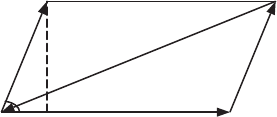
13.4 SOLUTIONS 1245
43. Solve for ~c to get ~c =−(~a +~
b). So
~
b×~c =~
b×(−(~a +~
b))
=−(~
b×(~a +~
b))
=−(~
b×~a +~
b×~
b)
=−(~
b×~a +~
0 )
=−(~
b×~a )
=~a ×~
b .
Also,
~c ×~a =−(~a +~
b)×~a
=−((~a +~
b)×~a )
=−(~a ×~a +~
b×~a )
=−(~
0 +~
b×~a )
=~a ×~
b .
Therefore, ~a ×~
b=~
b×~c =~c ×~a .
~
b
~
b
~c
~a
k~
bksin θ
θ
Figure 13.36
Geometrically, the magnitude of the cross product of two vectors is equal to the area of the parallelogram formed by
the vectors. If ~a +~
b+~c = 0, then we can think of the vectors ~a ,~
b, and ~c as forming a triangle. (See Figure 13.36.) So
by showing that
~a ×~
b=~
b×~c =~c ×~a ,
we are showing that the areas of the parallelograms formed by any two sides of the same triangle are equal.
44. The cross product is given by
~
b×~c =
~
i~
j~
k
b1b2b3
c1c2c3
=
b2b3
c2c3
~
i−
b1b3
c1c3
~
j+
b1b2
c1c2
~
k
so
~a ·(~
b×~c ) = a1
b2b3
c2c3−a2
b1b3
c1c3
+a3
b1b2
c1c2
=
a1a2a3
b1b2b3
c1c2c3
.
45. Write ~v and ~w in components and expand using the distributive property of the cross product.
~v ×~w = (v1
~
i+v2~
j+v3~
k)×(w1
~
i+w2~
j+w3~
k)
=v1w1
~
i×~
i+v1w2
~
i×~
j+v1w3
~
i×~
k
+v2w1~
j×~
i+v2w2~
j×~
j+v2w3~
j×~
k
+v3w1~
k×~
i+v3w2~
k×~
j+v3w3~
k×~
k
Now we use the fact that ~
i×~
i=~
0,~
i×~
j=~
k ,~
i×~
k=−~
j ,~
j×~
i=−~
k ,~
j×~
j=~
0,~
j×~
k=~
i ,~
k×~
i=
~
j ,~
k×~
j=−~
i ,~
k×~
k=~
0. Thus we have
~v ×~w =~
0 + v1w2~
k+v1w3(−~
j) + v2w1(−~
k) + ~
0 + v2w3
~
i+v3w1~
j+v3w2(−~
i) + ~
0
= (v2w3−v3w2)
~
i+ (v3w1−v1w3)~
j+ (v1w2−v2w1)~
k .

1246 Chapter Thirteen /SOLUTIONS
46. Any vector ~v that is perpendicular to both ~a and ~
bwill have the property that its dot product with ~a and ~
bis 0, that is
~a ·~v =a1x+a2y+a3z= 0,
~
b·~v =b1x+b2y+b3z= 0.
Multiply the first equation by b1and the second by a1and subtract to get
(b1a2−a1b2)y+ (b1a3−a1b3)z= 0 or y=−(b1a3−a1b3)z
(b1a2−a1b2)(for b1a26=a1b2)
Multiply the second equation by a2and the first by b2and subtract to get
(b2a1−a2b1)x+ (b2a3−a2b3)z= 0 or x=−(b2a3−a2b3)z
(b2a1−a2b1).
So
~v =−(b2a3−a2b3)z
(b2a1−a2b1)~
i−(b1a3−a1b3)z
(b1a2−a1b2)~
j+z~
k .
Pick z=b2a1−b1a2and multiply out, and we see that the algebraic method of finding a cross product yields the same
result as our standard method.
47. (a) Since ~c is perpendicular to ~a ×~
b, and since ~a ×~
bis normal to the plane containing ~a and ~
b, it follows that ~c must
be in the plane containing ~a and ~
b.
(b) Using the expression given in the problem for ~c , we get
~a ·~c =~a ·(~a ×(~
b×~a ))
= (~a ×~a )·(~
b×~a )
=~
0·(~
b×~a ) = 0.
and
~
b·~c =~
b·(~a ×(~
b×~a ))
= (~
b×~a )·(~
b×~a )
=k~
b×~a k2
=k~a k2k~
bk2−(~a ·~
b)2.
(c) Since ~c lies in the plane containing ~a and ~
b, it is of the form ~c =x~a +y~
bfor some scalars xand y. Thus, using
the fact that ~a ·~c = 0 from part (b), we have
~a ·~c =~a ·(x~a +y~
b) = xk~a k2+y(~a ·~
b) = 0.
Similarly, using the fact that ~
b·~c =k~a k2k~
bk2−(~a ·~
b)2from part (b), we have
~
b·~c =~
b·(x~a +y~
b) = x(~a ·~
b) + yk~
bk2=k~a k2k~
bk2−(~a ·~
b)2.
Solving these two linear equations in xand y, we find x=−~a ·~
band y=k~a k2.
48. Problem 41 tells us that (~u ×~v )·~w =~u ·(~v ×~w ). Using this result on the triple product of (~a +~
b)×~c with any
vector ~
dtogether with the fact that the dot product distributes over addition gives us:
[(~a +~
b)×~c ]·~
d= (~a +~
b)·(~c ×~
d)
=~a ·(~c ×~
d) +~
b·(~c ×~
d)(dot product is distributive)
= (~a ×~c )·~
d+ (~
b×~c )·~
d(using Problem 41 again)
= [(~a ×~c ) + (~
b×~c )] ·~
d . (dot product is distributive)
So, since [(~a +~
b)×~c ]·~
d= [(~a ×~c ) + (~
b×~c )] ·~
d, then
[(~a +~
b)×~c ]·~
d−[(~a ×~c ) + (~
b×~c )] ·~
d= 0,
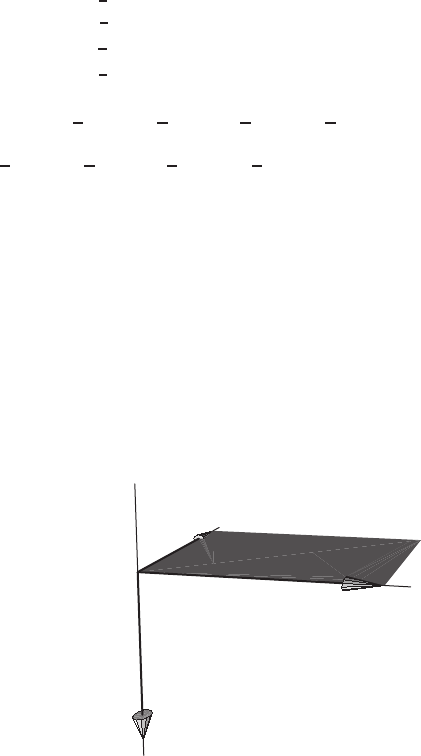
13.4 SOLUTIONS 1247
Since the dot product is distributive, we have
[((~a +~
b)×~c )−(~a ×~c )−(~
b×~c )] ·~
d= 0.
Since this equation is true for all vectors ~
d, by letting
~
d= ((~a +~
b)×~c )−(~a ×~c )−(~
b×~c ),
we get
k(~a +~
b)×~c −~a ×~c −~
b×~c k2= 0
and hence
(~a +~
b)×~c −(~a ×~c )−(~
b×~c ) = ~
0.
Thus
(~a +~
b)×~c = (~a ×~c ) + (~
b×~c ).
49. The area vector for face OAB =1
2~
b×~a .
The area vector for face OBC =1
2~a ×~c .
The area vector for face OAC =1
2~
b×~c .
The area vector for face ABC =1
2(~
b−~a )×(~c −~a ).
1
2~
b×~a +1
2~c ×~
b+1
2~a ×~c +1
2(~
b−~a )×(~c −~a ) =
1
2~
b×~a +1
2~c ×~
b+1
2~a ×~c +1
2(~
b×~c −~
b×~a −~a ×~c −~a ×~a ) = 0.
50. First let two adjoining sides of the rectangle be our vectors ~a and ~
b. See Figure 13.37. So we have
~a =~
jand ~
b= 2
~
i
Since it faces downward (that is, in the negative zdirection), according to the right hand rule ~
A=~a ×~
b. So, by the
formula for cross products
~
A=
~
i~
j~
k
01 0
2 0 0
=−2~
k .
y
x
z
~a
~
b
~
A
Figure 13.37
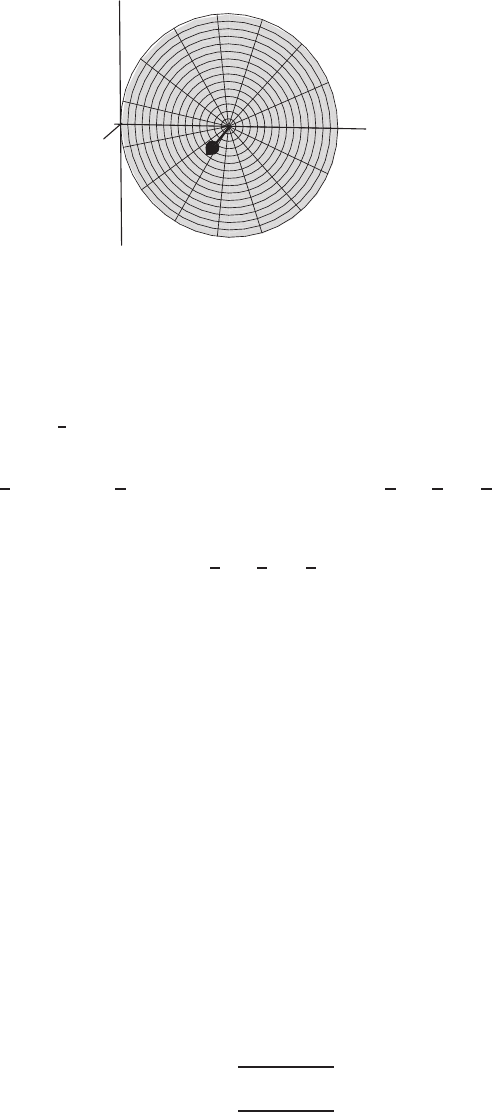
1248 Chapter Thirteen /SOLUTIONS
51. The area vector for a circle has a magnitude πr2and direction normal to the plane of the circle. See Figure 13.38. Thus,
since our circle is facing in the positive xdirection, and r= 2,
~
A=π(2)2
~
i= 4π~
i .
y
x
z
Figure 13.38
52. First choose vectors ~a and ~
balong the sides of the triangle. Let’s choose
~a =−→
AB = 2
~
i−~
j−~
k , ~
b=−→
AC =~
i−~
j .
These vectors then form two sides of a parallelogram whose area is k~a ×~
bk. Our triangle forms half of this parallelogram,
so the area of triangle ABC =1
2k~a ×~
bk. Since there are two possible orientations, the area of the triangle ABC is
represented by one of the following two vectors:
±1
2(~a ×~
b) = ±1
2(2
~
i−~
j−~
k)×(
~
i−~
j) = ±−1
2~
i−1
2~
j−1
2~
k
We want the upward orientation, so we pick the negative sign, giving
~
A=1
2~
i+1
2~
j+1
2~
k .
53. (a) Since
~u ×~v = (u2v3−u3v2)
~
i+ (u3v1−u1v3)~
j+ (u1v2−u2v1)~
k ,
we have
Area of S=k~u ×~v k=(u2v3−u3v2)2+(u3v1−u1v3)2+ (u1v2−u2v1)21/2.
(b) The two edges of Rare given by the projections of ~u and ~v onto the xy-plane. These are the vectors ~
Uand ~
V,
obtained by omitting the ~
k-components of ~u and ~v : we have ~
U=u1
~
i+u2~
jand ~
V=v1
~
i+v2~
j, Thus
Area of R=k~
U×~
Vk=k(u1v2−u2v1)~
kk=|u1v2−u2v1|.
(c) The vector m
~
i+n~
j−~
kis normal to the plane z=mx +ny +c. Since the vectors ~u and ~v are in the plane
(they’re the sides of ~
S), the vector ~u ×~v is also normal to the plane. Thus, these two vectors are scalar multiples of
one another. Suppose
~u ×~v =λ(m
~
i+n~
j−~
k)
Since the ~
kcomponent of ~u ×~v is (u1v2−u2v1)~
k, comparing the ~
k-components tells us that
λ=−(u1v2−u2v1).
Thus,
−(u1v2−u2v1)(m
~
i+n~
j−~
k) = ~u ×~v = (u2v3−u3v2)
~
i+ (u3v1−u1v3)~
j+ (u1v2−u2v1)~
k ,
so
m=u2v3−u3v2
u2v1−u1v2
n=u3v1−u1v3
u2v1−u1v2
.
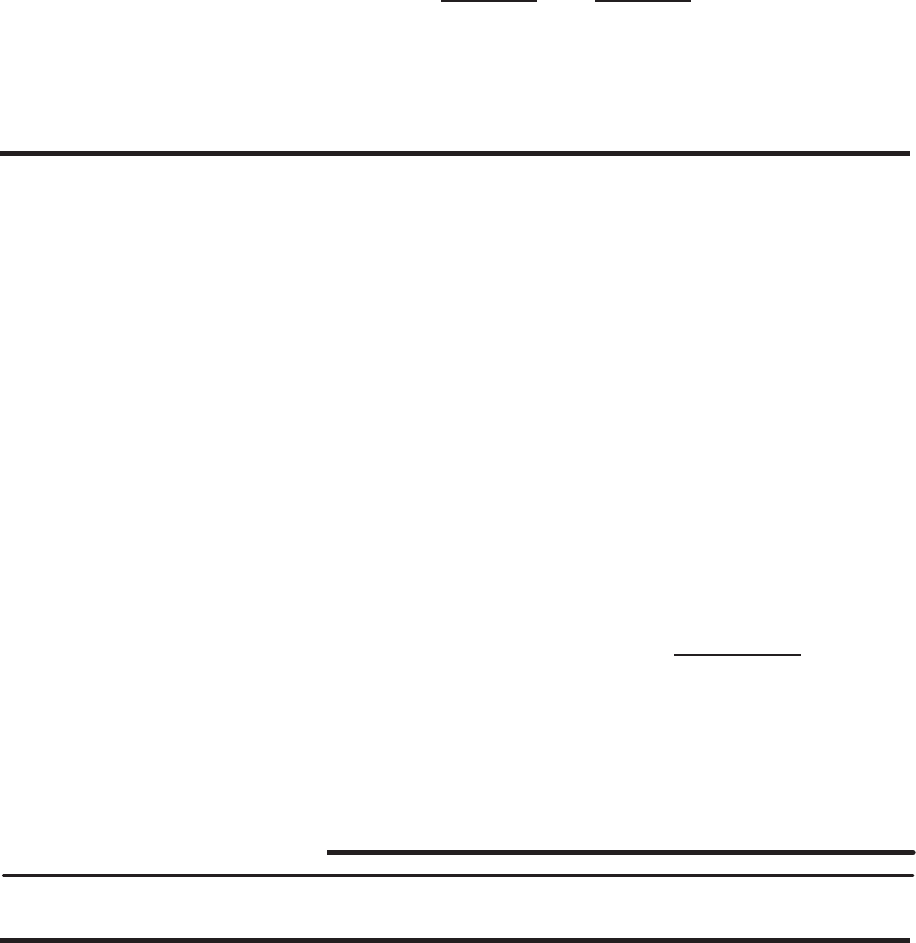
SOLUTIONS to Review Problems for Chapter Thirteen 1249
(d) We have
(1 + m2+n2)·(Area of R)2=1 + u2v3−u3v2
u2v1−u1v22
+u3v1−u1v3
u2v1−u1v22(u1v2−u2v1)2
=(u2v3−u3v2)2+ (u3v1−u1v3)2+ (u1v2−u2v1)2
=(Area of S)2.
Strengthen Your Understanding
54. If ~n is unit vector perpendicular to ~u and ~v , then so is −~n . There are exactly two possible unit vectors perpendicular to
two given nonparallel vectors. The right-hand rule gives one of the two.
55. ~u ×~v =~
0when ~u and ~v are parallel, not perpendicular.
56. Since ~u ×~v is perpendicular to the plane containing ~u and ~v , we want ~
kto be perpendicular to the plane containing ~u
and ~v . That is, we want ~u and ~v to both lie in the xy-plane. Thus choose ~u to be any nonzero vector in the xy-plane not
parallel to ~v . For example, let ~u = 2
~
i+~
j.
57. We could let ~v =a
~
i+b~
j+c~
k, compute k~u ×~v kin terms of a, b, c, set the length equal to 10, and solve to find values
of a, b, c. It is much easier to think geometrically. Let ~v be any vector perpendicular to ~u , forming a rectangle of area 10.
Since k~u k= 5, that means we can choose vto be any vector perpendicular to ~u of length 2. So first find a unit vector
perpendicular to ~u , say 4
~
i−3~
j, unitize it to get (4/5)
~
i−(3/5)~
jand then scale it by 2. We get (8/5)
~
i−(6/5)~
j.
58. True. The cross product yields a vector.
59. False. ~u ×~v has direction perpendicular to both ~u and ~v .
60. False. This is only true when ~u and ~v are perpendicular. In general, k~u ×~v k=k~u kk~v ksin θ, where θis the angle
between ~u and ~v . The value of k~u ×~v kis the area of the parallelogram with sides ~u and ~v .
61. True. The left-hand side evaluates to ~
k·~
k= 1, while the right-hand side evaluates to~
i·~
i= 1.
62. False. If ~u and ~w are two different vectors both of which are parallel to ~v , then ~v ×~u =~v ×~w =~
0, but ~u 6=~w . A
counterexample is ~v =~
i , ~u = 2
~
iand ~w = 3
~
i.
63. True. Since (~v ×~w )is perpendicular to ~v , the dot product with ~v is zero.
64. True. The cross product is a vector in 3-space, while the dot product is a scalar, so they cannot be equal.
65. True. The cross product (
~
i+~
j)×(~
j+ 2~
k) = 2
~
i−2~
j+~
k, which has magnitude p22+ (−2)2+ 12= 3. Since the
triangle has area of 1/2the parallelogram with the given vectors as sides, the triangle has area 3/2.
66. True. Any vector ~w that is parallel to ~v will give ~v ×~w =~
0.
67. False. It is not true in general, but there are special cases when ~v ×~w =~w ×~v . For example, when ~v is parallel to ~w ,
or when one of the vectors is ~
0. In either case the cross products ~v ×~w and ~w ×~v are both the zero vector.
Solutions for Chapter 13 Review
Exercises
1. Scalar. ~u ·~v = (2
~
i−3~
j−4~
k)·(~
k−~
j) = 2 ·0−3(−1) −4·1 = −1.
2. Vector. We calculate
~u ×~v =
~
i~
j~
k
2−3−4
3−1 1
=−7
~
i−14~
j+ 7~
k .
3. 4−9 + 4 = −1
4. ~
i·(−~
i) = −1
5. ~a =−2~
j,~
b= 3
~
i,~c =~
i+~
j,~
d= 2~
j,~e =~
i−2~
j,~
f=−3
~
i−~
j.

1250 Chapter Thirteen /SOLUTIONS
6. Resolving ~v into components gives ~v = 8 cos(40◦)
~
i−8 sin(40◦)~
j= 6.13
~
i−5.14~
j. Notice that the component in
the ~
jdirection must be negative.
7. 5~c = 5
~
i+ 30~
j
8. ~c +~x +~y =~
i+ 6~
j−2
~
i+ 9~
j+ 4
~
i−7~
j= 3
~
i+ 8~
j .
9. ||~x −~c || =|| − 2
~
i+ 9~
j−(
~
i+ 6~
j)|| =|| − 3
~
i+ 3~
j|| = 3√2.
10. ~v + 2 ~w = 2
~
i+ 3~
j−~
k+ 2(
~
i−~
j+ 2~
k) = 4
~
i+~
j+ 3~
k.
11. 3~v −~w −~v = 2~v −~w = 2(2
~
i+ 3~
j−~
k)−(
~
i−~
j+ 2~
k) = 3
~
i+ 7~
j−4~
k.
12. ||~v +~w || =||3
~
i+ 2~
j+~
k|| =√32+ 22+ 12=√14.
13. ~v ·~w = (2
~
i+ 3~
j−~
k)·(
~
i−~
j+ 2~
k) = 2 ·1 + 3 ·(−1) + (−1) ·2 = −3.
14. ~v ×~w =
~
i~
j~
k
2 3 −1
1−1 2
= (6 −1)
~
i−(4 + 1)~
j+ (−2−3)~
k= 5
~
i−5~
j−5~
k.
15. For any vector ~v , we have ~v ×~v =~
0.
16. Since ~v ·~w = 2 ·1 + 3(−1) + (−1)2 = −3, we have (~v ·~w )~v =−6
~
i−9~
j+ 3~
k.
17. Since ~v ×~w is perpendicular to ~w , we have (~v ×~w )·~w = 0.
18. We have ~v ×~w = 5
~
i−5~
j−5~
k, so
(~v ×~w )×~w =
~
i~
j~
k
5−5−5
1−12
= (−10 −5)
~
i−(10 + 5)~
j+ (−5 + 5)~
k=−15
~
i−15~
j .
19. The cross product of two parallel vectors is ~
0, so the cross product of any vector with itself is ~
0.
20. A normal vector can be obtained from the coefficients of x,y,zin the equation of the plane and is: ~n = 2
~
i+~
j−~
k.
21. The equation can be rewritten as
z−5x+ 10 = 15 −3y
−5x+ 3y+z= 5
so ~n =−5
~
i+ 3~
j+~
k.
22. If the planes are parallel, they have a common normal vector ~n . Rewrite the equation of the plane as 4x−3y−z=−8
so that ~n = 4
~
i−3~
j−~
kand the desired plane is 4(x−0) −3(y−0) −(z−0) = 0 or 4x−3y−z= 0.
23. (a) We have ~v ·~w = 3 ·4 + 2 ·(−3) + (−2) ·1 = 4.
(b) We have ~v ×~w =−4
~
i−11~
j−17~
k.
(c) A vector of length 5 parallel to ~v is
5
k~v k~v =5
√17 (3
~
i+ 2~
j−2~
k) = 3.64
~
i+ 2.43~
j−2.43~
k .
(d) The angle between vectors ~v and ~w is found using
cos θ=~v ·~w
k~v kk~w k=4
√17√26 = 0.190,
so θ= 79.0◦.
(e) The component of vector ~v in the direction of vector ~w is
~v ·~w
k~w k=4
√26 = 0.784.
(f) The answer is any vector ~a such that ~a ·~v = 0. One possible answer is 2
~
i−2~
j+~
k.
(g) A vector perpendicular to both is the cross product:
~v ×~w =−4
~
i−11~
j−17~
k .
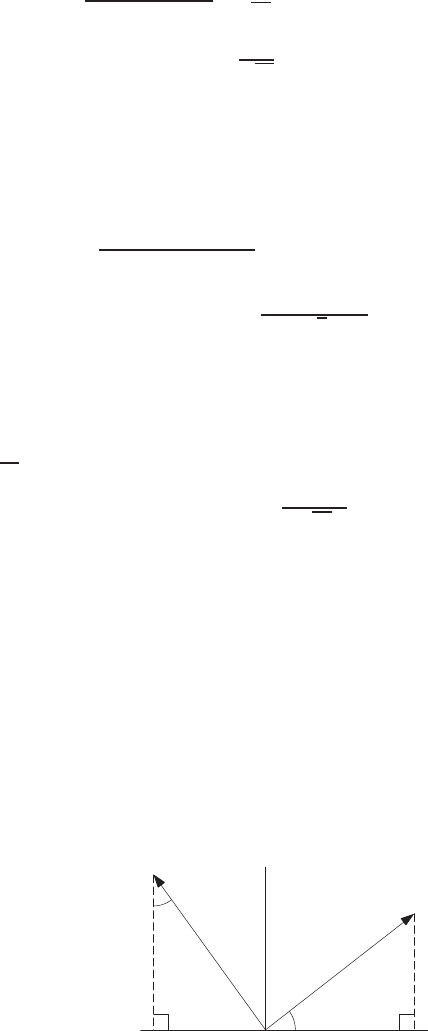
SOLUTIONS to Review Problems for Chapter Thirteen 1251
24. Since ||2
~
i+ 3~
j−~
k|| =p22+ 32+ (−1)2=√14, vectors of length 10 are
±10
√14 (2
~
i+ 3~
j−~
k).
25. We take the cross product of~
i+~
jand~
i−~
j−~
kand then make a unit vector parallel to the cross product.
(
~
i+~
j)×(
~
i−~
j−~
k) =
~
i~
j~
k
1 1 0
1−1−1
=−~
i+~
j−2~
k .
Since || −~
i+~
j−2~
k|| =p(−1)2+ 12+ (−2)2= 6, unit vectors are
±−~
i+~
j−2~
k
√6.
26. We want a unit vector of the form a
~
i+b~
jsuch that
(a
~
i+b~
j)·(3
~
i−2~
j) = 3a−2b= 0.
Let’s take a= 2 and b= 3. Then the vector 2
~
i+ 3~
jis perpendicular to 3
~
i−2~
j, but 2
~
i+ 3~
jis not a unit vector. Since
||2
~
i+ 3~
j|| =√13, unit vectors are
±2
~
i+ 3~
j
√13 .
27. ~n = 4
~
i+ 6~
k(the coefficients of x, y, z are the same as the coefficients of~
i,~
j, and ~
k.)
28. First, we rewrite the equation of the plane as
x−y−z= 1.
In this form, the coefficients of x, y, and zare the coefficients of~
i ,~
j, and ~
kin a vector that is perpendicular to the plane.
So any scalar multiple of~
i−~
j−~
kis perpendicular to the plane.
29. The vector ~w we want is shown in Figure 13.39, where the given vector is ~v = 4
~
i+ 3~
j. The vectors ~v and ~w are the
same length and the two angles marked αare equal, so the two right triangles shown are congruent. Thus
a=−3and b= 4.
Therefore
~w =−3
~
i+ 4~
j .
3 4
3
4
(a, b)
(4,3)
~v
~w
α
αx
y
Figure 13.39
30. The cross product of two vectors is perpendicular to both of them, so a possible answer is
~v ×~w =
~
i~
j~
k
3−11
1−2 1
=~
i−2~
j−5~
k .

1252 Chapter Thirteen /SOLUTIONS
31. To determine if two vectors are parallel, we need to see if one vector is a scalar multiple of the other one. Since ~u =−2~w ,
and ~v =1
4~q and no other pairs have this property, only ~u and ~w , and ~v and ~q are parallel.
32. Since ~
F= 2~
d, the two vectors are parallel in the same direction, so
~
Fparallel =~
Fand ~
Fperp =~
0.
The work done is
W=~
F·~
d= 2 + 8 = 10.
Notice that this is the same as the magnitude of the force, k~
Fk=√20, times the distance traveled, k~
dk=√5, since the
force is the same direction as the displacement.
33. Since ~
F=−2~
d, the two vectors are parallel in opposite directions, so
~
Fparallel =~
Fand ~
Fperp =~
0.
The work done is
W=~
F·~
d=−10.
Note that work done is negative since the force is in the opposite direction to the displacement.
34. Since ~
F·~
d= 0, the two vectors are perpendicular, so
~
Fparallel =~
0and ~
Fperp =~
F .
The work done is
W=~
F·~
d= 0.
No work is done since the force is perpendicular to the displacement.
35. The unit vector in the direction of ~
dis ~u = (3/5)
~
i−(4/5)~
j. Thus
~
Fparallel =~
F·~
u~u =−10
5~u =−6
5~
i+8
5~
j ,
~
Fperp =~
F−~
Fparallel =16
5~
i+12
5~
j .
Notice that ~
Fperp ·~u = 0, as we expect. The work done is
W=~
F·~
d= 6 −16 = −10.
The work is negative since ~
Fparallel is in the opposite direction of the displacement vector ~
d.
36. The unit vector in the direction of ~
dis ~u = (1/√2)(
~
i+~
j). Thus
~
Fparallel =~
F·~u ~u =2
√2~u =~
i+~
j ,
~
Fperp =~
F−~
Fparallel =~
i−~
j .
Notice that ~
Fperp ·~u = 0, as we expect. The work done is
W=~
F·~
d= 2 −0 = 2.
37. The unit vector in the direction of ~
d= 3~
jis ~u =~
j. Thus, the parallel component of ~
Fis just its jcomponent, and the
perpendicular component is its icomponent:
~
Fparallel = 2~
jand ~
Fperp = 5
~
i .
The work done is
W=~
F·~
d= 6.
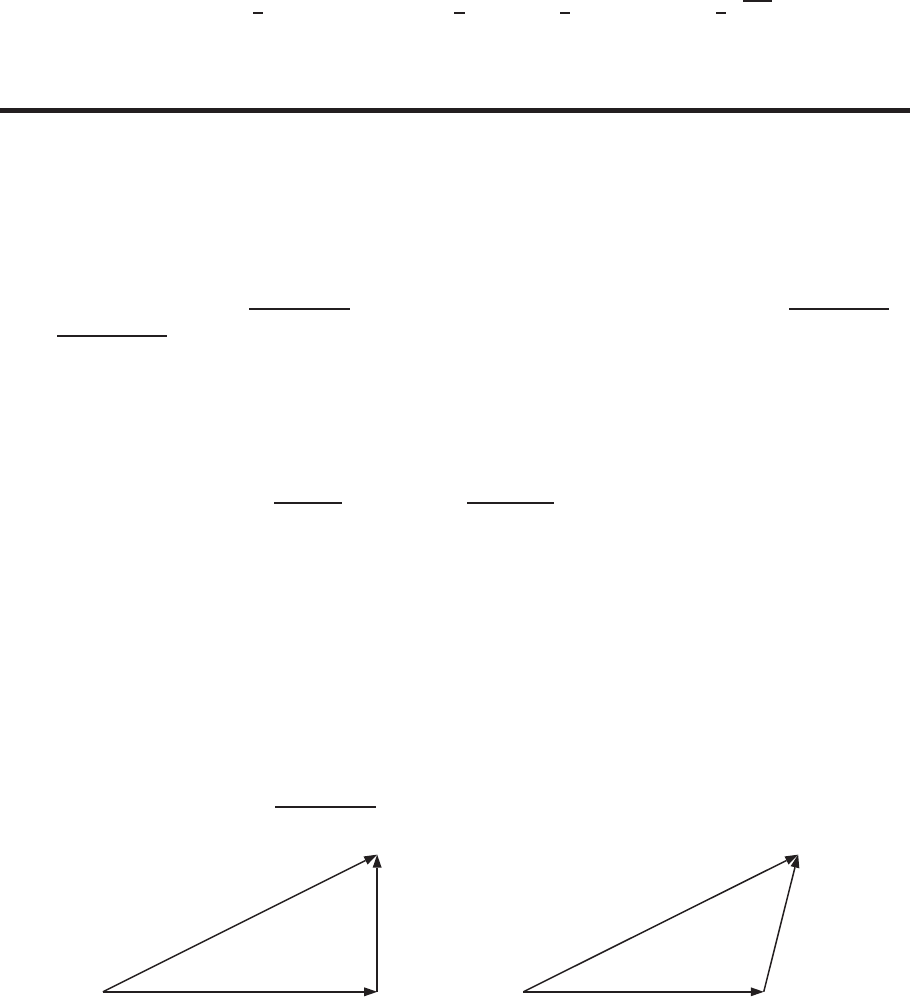
SOLUTIONS to Review Problems for Chapter Thirteen 1253
38. The area of the triangle is half the area of the parallelogram created by these two vectors, and the area of the parallelogram
is the magnitude of the cross product. We first calculate the cross product:
~a ×~
b=
~
i~
j~
k
1 2 −1
4−2 1
= 0
~
i−5~
j−10~
k .
The area of the triangle is given by:
Area of triangle =1
2Area of parallelogram =1
2k~a ×~
bk=1
2k − 5~
j−10~
kk=1
2√125 = 5.590.
Problems
39. (a) True, since vectors ~c and ~
fpoint in the same direction and have the same length.
(b) False, since vectors ~a and ~
dpoint in opposite directions. We have ~a =−~
d.
(c) False, since −~
bpoints in the opposite direction to ~
b, the vectors −~
band ~a are perpendicular.
(d) True. The vector ~
fcan be ”moved” to point directly up the z-axis.
(e) True. We move in the positive x-direction following vector ~a and then in the positive y-direction following vector
−~
b. The resulting sum is the vector ~e .
(f) False, vector ~
dis the negative of the vector ~g −~c . It is true that ~
d=~c −~g .
40. Let the velocity vector of the airplane be ~
V=x
~
i+y~
j+z~
kin km/hr. We know that x=−ybecause the plane is traveling
northwest. Also, k~
Vk=px2+y2+z2= 200 km/hr and z= 300 m/min = 18 km/hr. We have px2+y2+z2=
√x2+x2+ 182= 200, so x=−140.8, y = 140.8, z = 18. (The value of xis negative and yis positive because the
plane is heading northwest.) Thus,
~v =−140.8
~
i+ 140.8~
j+ 18~
k .
41. The velocity vector of the plane with respect to the air has the form
~v =a
~
i+ 80~
kwhere k~v k= 480.
(See Figure 13.40.) Therefore √a2+ 802= 480 so a=√4802−802≈473.3km/hr. We conclude that ~v ≈473.3
~
i+
80~
k .
The wind vector is
~w = 100(cos 45◦)
~
i+ 100(sin 45◦)~
j
≈70.7
~
i+ 70.7~
j
The velocity vector of the plane with respect to the ground is then
~v +~w = (473.3
~
i+ 80~
k) + (70.7
~
i+ 70.7~
j)
= 544
~
i+ 70.7~
j+ 80~
k
From Figure 13.41, we see that the velocity relative to the ground is
544
~
i+ 70.7~
j .
The ground speed is therefore √5442+ 70.72≈548.6km/hr.
a
~
i
50~
k
~v
Figure 13.40
: Side view
a
~
i
Velocity relative
to ground
~w
Figure 13.41
: Top view
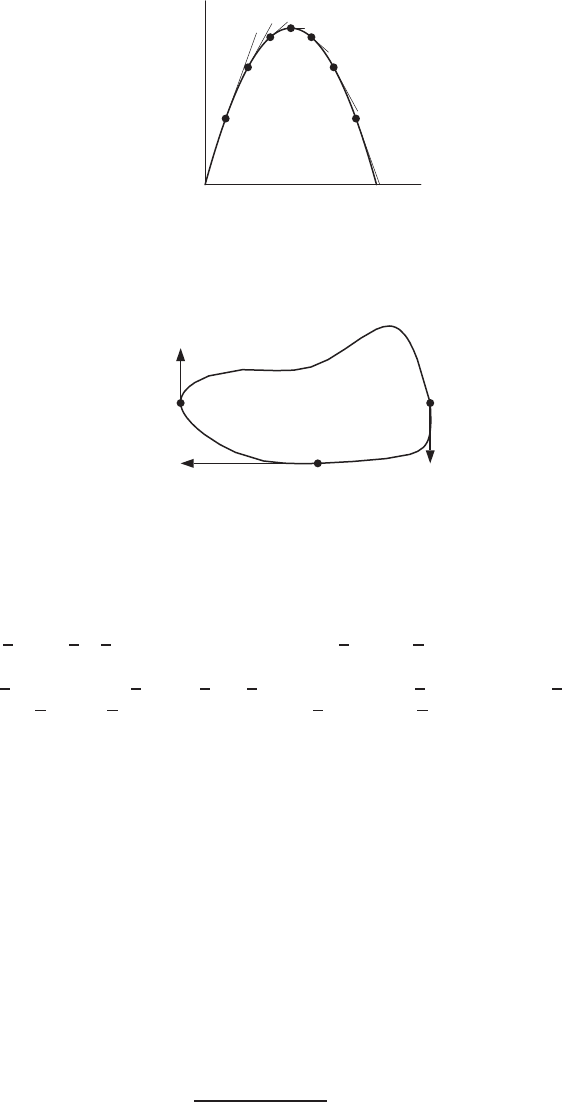
1254 Chapter Thirteen /SOLUTIONS
42. (a) See Figure 13.42. Notice that the velocity vectors are tangent to the curve, they point in the direction of motion, and
they are longer when the rocket is moving faster.
>
>
>
>
>
>
>
Figure 13.42
(b) If the rocket has a parachute, it comes down more slowly. The velocity vectors on the downward part of the graph are
shorter for this rocket.
43. See Figure 13.43.
P R
Q
Figure 13.43
44. At the point P, the velocity of the car is changing the quickest; not in magnitude, but in direction only. The acceleration
vector is therefore the longest at this point. The direction of the vector is directed in toward the center of the track because
the difference in velocity vectors at nearby points is a vector pointing toward the center.
45. Since 3
~
i+√3~
j=√3(√3
~
i+~
j), we know that 3
~
i+√3~
jand √3
~
i+~
jare scalar multiples of one another, and
therefore parallel.
Since (√3
~
i+~
j)·(
~
i−√3~
j) = √3−√3 = 0, we know that √3
~
i+~
jand~
i−√3~
jare perpendicular.
Since 3
~
i+√3~
jand √3
~
i+~
jare parallel, 3
~
i+√3~
jand~
i−√3~
jare perpendicular, too.
46. Let the x-axis point east and the y-axis point north. We resolve the forces into components. Since the first force points
50◦south of east with a force of 25 newtons, we have
~
F1= 25 cos(50◦)
~
i−25 sin 50◦~
j= 16.070
~
i−19.151~
j .
Since ~
F1lies in the fourth quadrant, the coefficient of~
iis positive and the coefficient of ~
jis negative.
The second force points 70◦north of west with a force of 60 newtons, so we have
~
F2=−60 cos(70◦)
~
i+ 60 sin 70◦~
j=−20.521
~
i+ 56.382~
j .
Since ~
F2lies in the second quadrant, the coefficient of~
iis negative and the coefficient of ~
jis positive.
The third force must make the total force equal to zero, so we have
~
F1+~
F2+~
F3=~
0
~
F3=−(~
F1+~
F2)
=−((16.070
~
i−19.151~
j) + (−20.521
~
i+ 56.382~
j))
=−(−4.451
~
i+ 37.231~
j)
= 4.451
~
i−37.231~
j .
The magnitude of this force is k~
F3k=√4.4512+ 37.2312= 37.50 newtons. The direction is arctan(37.231/4.451) =
83.20◦south of east.
47. If the vectors are perpendicular, we need
~v ·~w = (2a
~
i−a~
j+ 16~
k)·(5
~
i+a~
j−~
k) = 10a−a2−16 = 0.
Solving 10a−a2−16 = −(a−2)(a−8) = 0 gives a= 2,8.
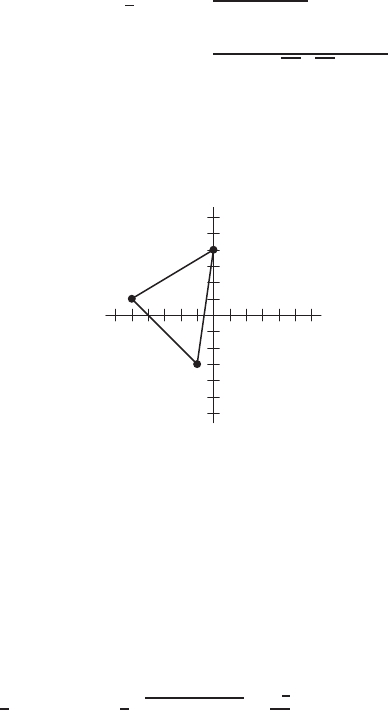
SOLUTIONS to Review Problems for Chapter Thirteen 1255
48. Since a normal vector of the plane is ~n =−~
i+ 2~
j+~
k, an equation for the plane is
−x+ 2y+z=−1 + 2 ·0 + 2 = 1
−x+ 2y+z= 1.
49. Since the plane is normal to the vector 2
~
i−3~
j+ 7~
kand passes through the point (1,−1,2), an equation for the plane is
2x−3y+ 7z= 2 ·1−3·(−1) + 7 ·2 = 19
2x−3y+ 7z= 19.
50. See Figure 13.44. One way to find the angle at Ais to find the angle between vectors −→
AB and −→
AC. Since −→
AB =−1
~
i−7~
j
and −→
AC =−5
~
i−3~
j, we have
cos(6BAC) = −→
AB ·−→
AC
k−→
ABkk−→
ACk
=(−1)(−5) + (−7)(−3)
√50√34
= 0.6306.
Thus the angle at vertex Ais 50.91◦. Similarly, we see that the angle at vertex Bis 53.13◦and (since the angles of a
triangle add up to 180◦) the angle at vertex Cis 75.96◦.
−6−4−2 2 4 6
−6
−4
−2
2
4
6
A
B
C
x
y
Figure 13.44
51. Let ~r 1be the displacement vector −−→
P Q and let ~r 2be the displacement vector −→
P R. Then
~r 1= (1 + 2)
~
i+ (3 −2)~
j+ (−1−0)~
k= 3
~
i+~
j−~
k ,
~r 2= (−4 + 2)
~
i+ (2 −2)~
j+ (1 −0)~
k=−2
~
i+~
k ,
~r 1×~r 2=
~
i~
j~
k
31−1
−2 0 1
=~
i−(3 −2)~
j+ 2~
k=~
i−~
j+ 2~
k .
The area of the triangle =1
2k~r 1×~r 2k=1
2√12+ 12+ 22=√6
2.
52. (a) The displacement vector −→
AB lies in the plane and is given by
−→
AB = (0 −2)
~
i+ (1 −1)~
j+ (3 −0)~
k=−2
~
i+ 3~
k .
Similarly, the displacement vector −→
AC also lies in the plane,
−→
AC = (1 −2)
~
i+ (0 −1)~
j+ (1 −0)~
k=−~
i−~
j+~
k .
(b) The vector ~n =−→
AB ×−→
AC is perpendicular to both −→
AB and −→
AC and is therefore perpendicular to the plane.
−→
AB ×−→
AC = (−2
~
i+ 3~
k)×(−~
i−~
j+~
k) = 3
~
i−~
j+ 2~
k .
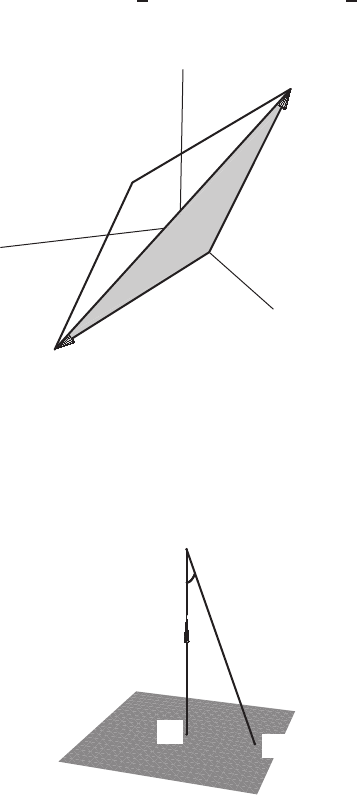
1256 Chapter Thirteen /SOLUTIONS
(c) The normal vector to the plane is ~n = 3
~
i−~
j+ 2~
k, so the equation is of the form
3x−y+ 2z=d.
Substituting, for example, x= 1,y= 0,z= 1 gives d= 5:
3x−y+ 2z= 5.
53. (a) If we let −−→
P Q in Figure 13.45 be the vector from point Pto point Qand −→
P R be the vector from Pto R, then
−−→
P Q =−~
i+ 2~
k
−→
P R = 2
~
i−~
k ,
then the area of the parallelogram determined by −−→
P Q and −→
P R is:
Area of
parallelogram =k−−→
P Q ×−→
P Rk=
~
i~
j~
k
−10 2
2 0 −1
=k3~
jk= 3.
Thus, the area of the triangle P QR is
Area of
triangle !=1
2 Area of
parallelogram !=3
2= 1.5.
x
y
z
P= (0,1,0)
Q= (−1,1,2)
(2,1,−1) = R
Figure 13.45
(b) Since ~n =−−→
P Q ×−→
P R is perpendicular to the plane P QR, and from above, we have ~n = 3~
j, the equation of the
plane has the form 3y=C. At the point (0,1,0) we get 3 = C, therefore 3y= 3, i.e., y= 1.
54. Find an arbitrary point on the plane 2x+ 4y−z=−1, say A= (0,0,1). The normal ~n to the plane at Bis ~n =
2
~
i+ 4~
j−~
kand −→
P A =−2
~
i+~
j−2~
k. See Figure 13.46.
θ
BA
~n
P
Figure 13.46

SOLUTIONS to Review Problems for Chapter Thirteen 1257
So the distance dfrom the point Pto the plane is
d=k−−→
P Bk=k−→
P Akcos θ
=−→
P A ·~n
k~n ksince −→
P A ·~n =k−→
P Akk~n kcos θ)
=(−2
~
i+~
j−2~
k)·(2
~
i+ 4~
j−~
k)
p22+ 42+ (−1)2
=2
√21 .
55. The displacement from (1,1,1) to (1,4,5) is
~r1= (1 −1)
~
i+ (4 −1)~
j+ (5 −1)~
k= 3~
j+ 4~
k .
The displacement from (−3,−2,0) to (1,4,5) is
~r2= (1 + 3)
~
i+ (4 + 2)~
j+ (5 −0)~
k= 4
~
i+ 6~
j+ 5~
k .
A normal vector is
~n =~r1×~r2=
~
i~
j~
k
03 4
4 6 5
= (15 −24)
~
i−(−16)~
j+ (−12)~
k=−9
~
i+ 16~
j−12~
k .
The equation of the plane is
−9x+ 16y−12z=−9·1 + 16 ·1−12 ·1 = −5
9x−16y+ 12z= 5.
We pick a point Aon the plane, A= ( 5
9,0,0) and let P= (0,0,0). (See Figure 13.47.) Then ~
P A = (5/9)
~
i.
θ
BA
~n
P
Figure 13.47
So the distance dfrom the point Pto the plane is
d=k−−→
P Bk=k−→
P Akcos θ
=−→
P A ·~n
k~n ksince −→
P A ·~n =k−→
P Akk~n kcos θ)
=
(5
9~
i)·(−9
~
i+ 16~
j−12~
k)
√92+ 162+ 122
=5
√481 = 0.23.

1258 Chapter Thirteen /SOLUTIONS
56. (a) 500 km/hr in the west direction, so ~v =−500
~
i.
(b) While traveling at constant altitude, the plane travels 250 km westward. Thus the coordinates of the point where the
plane begins to descend are (550,60,4) −(250,0,0) = (300,60,4).
(c) The vector from the plane to the airport at the time it begins its descent is (200
~
i+ 10~
j)−(300
~
i+ 60~
j+ 4~
k) =
−100
~
i−50~
j−4~
k. Velocity is a vector of length 200 km/hr in the direction of −100
~
i−50~
j−4~
k. Since
p(−100)2+ (−50)2+ (−4)2≈111.9, a unit vector in the direction of descent is −100
111.9~
i−50
111.9~
j−4
111.9~
k.
Thus
Velocity vector = 200−100
111.9~
i−50
111.9~
j−4
111.9~
k=−178.7
~
i−89.4~
j−7.2~
k .
57. Let ~v =vx
~
i+vy~
j+vz~
kbe the vector. We will use the properties given in the problem to find vx,vy, and vz. If ~v has
magnitude 10, then k~v k= 10.
If ~v makes an angle of 45◦with the x-axis, then its x-component, vx, is given by:
vx=~v ·~
i=k~v kcos 45◦= 10 √2
2= 7.0710.
Similarly, if ~v makes a 75◦angle with the y-axis, then its y-component, vy, is given by:
vy=~v ·~
j=k~v kcos 75◦= 10(0.25882) = 2.5882.
We now have two components of ~v :
~v = 7.0710
~
i+ 2.5882~
j+vz~
k .
We only need to find vz. To do this we use the fact that √~v ·~v =k~v k= 10.
~v ·~v = 100
v2
x+v2
y+v2
z= 100
v2
z= 100 −v2
x−v2
y
v2
z=±p100 −v2
x−v2
y
vz=±6.580
Since the problem tells us that the ~
k-component is positive, vz= +6.580. Thus
~v = 7.0710
~
i+ 2.5882~
j+ 6.580~
k .
58. (a) Suppose ~v =−−→
OP as in Figure 13.48. The~
icomponent of −−→
OP is the projection of −−→
OP on the x-axis:
−→
OT =vcos α
~
i .
Similarly, the ~
jand ~
kcomponents of −−→
OP are the projections of −−→
OP on the y-axis and the z-axis respectively. So:
−→
OS =vcos β~
j
−−→
OQ =vcos γ~
k
Since ~v =−→
OT +−→
OS +−−→
OQ, we have
~v =vcos α
~
i+vcos β~
j+vcos γ~
k .
(b) Since
v2=~v ·~v = (vcos α
~
i+vcos β~
j+vcos γ~
k)·
(vcos α
~
i+vcos β~
j+vcos γ~
k)
=v2(cos2α+ cos2β+ cos2γ)
so
cos2α+ cos2β+ cos2γ= 1.
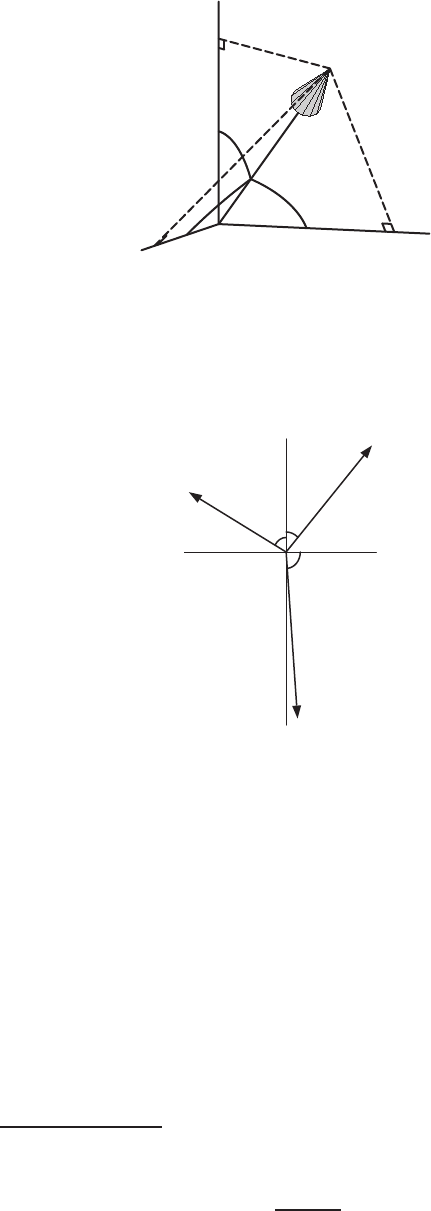
SOLUTIONS to Review Problems for Chapter Thirteen 1259
x
y
z
TS
Q
α
β
γ
Figure 13.48
59. Let the x-axis point east and the y-axis point north. Denote the forces exerted by Charlie, Sam and Alice by ~
FC,~
FSand
~
FA(see Figure 13.49).
y
x
~
FC
~
FS
~
FA
62◦43◦
φ
Figure 13.49
Since k~
FCk= 175 newtons and the angle θfrom the x-axis to ~
FCis 90◦+ 62◦= 152◦, we have
~
FC= 175 cos 152◦~
i+ 175 sin 152◦~
j≈ −154.52
~
i+ 82.16~
j .
Similarly, ~
FS= 200 cos 47◦~
i+ 200 sin 47◦~
j≈136.4
~
i+ 146.27~
j .
Now Alice is to counterbalance Sam and Charlie, so the resultant force of the three forces ~
FC,~
FSand ~
FAmust be 0,
that is, ~
FC+~
FS+~
FA= 0.
Thus, we have
~
FA=−~
FC−~
FS
≈ −(−154.52
~
i+ 82.16~
j)−(136.4
~
i+ 146.27~
j)
= 18.12
~
i−228.43~
j
and, k~
FAk=p18.122+ (−228.43)2≈229.15 newtons.
If φis the angle from the x-axis to ~
FA, then
φ= arctan −228.43
18.12 ≈ −85.5◦.

1260 Chapter Thirteen /SOLUTIONS
CAS Challenge Problems
60. (~a ×~
b)·~c = 0 ,(~a ×~
b)×(~a ×~c ) = ~
0
Since ~c is the sum of a scalar multiple of ~a and a scalar multiple of ~
b, it lies in the plane containing ~a and ~
b. On
the other hand, ~a ×~
bis perpendicular to this plane, so ~a ×~
bis perpendicular to ~c . Therefore, (~a ×~
b)·~c = 0. Also,
~a ×~c is also perpendicular to the plane, thus parallel to ~a ×~
b, and thus (~a ×~
b)×(~a ×~c ) = ~
0.
61. The first parallelepiped has volume
|(~a ×~
b)·~c |=|ywr −vzr +zus −xws +xvt −yut|.
The second has volume |(~a ×~
b)·(2~a −~
b+~c )|, which also simplifies to |ywr −vzr +zus −xws +xvt −yut|.
Both parallelepipeds have base with edges ~a and ~
b. The third edge of the first one is ~c and the third edge of the second
one is ~c + 2~a −~
b. Thus the top face of the second parallelepiped is obtained by shifting the top face of the first by
2~a −~
b. Since this is parallel to the base, the second parallelepiped has the same altitude as the first. Since the volume of
a parallelepiped is product of the area of its base with its height, the two parallelepipeds have the same volume.
62. (a) From the geometric definition of the dot product, we have
cos θ=|~a ·~
b|
k~a kk~
bk=10
√14√9.
Using sin2θ= 1 −cos2θ, we get
x+ 2y+ 3z= 0
2x+y+ 2z= 0
x2+y2+z2=k~a k2k~
bk2(1 −cos2θ) = (14)(9) 1−100
(14)(9)
Solving these equations we get x=−1,y=−4,z=3or x= 1,y= 4, and z=−3. Thus ~c =−~
i−4~
j+ 3~
k
or ~c =~
i+ 4~
j−3~
k.
(b) ~a ×~
b=~
i+ 4~
j−3~
k. This is the same as one of the answers in part (a). The conditions in part (a) ensured that
~c is perpendicular to ~a and ~
band that it has magnitude k~a kk~
bk|sin θ|. The cross product is the solution that, in
addition, satisfies the right-hand rule.
63. (a) We have
k−→
ABk=k2
~
ik= 2
k−→
ACk=k~
i+√3~
jk=√1 + 3 = 2
k−−→
ADk=k~
i+ (1/√3)~
j+ 2p2/3~
kk=p1 + (1/3) + (8/3) = √4 = 2
k−−→
BCk=k −~
i+√3~
jk=√1 + 3 = 2
k−−→
BDk=k −~
i+ (1/√3)~
j+ 2p2/3~
kk=p1 + (1/3) + (8/3) = √4 = 2
k−−→
CDk=k(1/√3−√3)~
j+ 2p2/3~
k)k=p(1/3−2 + 3) + 8/3 = √4 = 2
Thus all the points are 2 units apart.
(b) By solving the equations
x2+y2+z2= (x−2)2+y2+z2
x2+y2+z2= (x−1)2+ (y−√3)2+z2
x2+y2+z2= (x−1)2+ (y−1/√3)2+ (z−2p2/3)2
we get P= (1,1/√3,√6/6).
(c) The cosine of the angle AP B is 1/3and the angle is 109.471◦.
64. (a) −−→
P Q×−→
P R is perpendicular to the plane containing P,Q,R, and therefore parallel to the normal vector a
~
i+b~
j+c~
k.
(b)
−−→
P Q ×−→
P R = (tv −sw −ty +wy +sz −vz)
~
i+
(−tu +rw +tx −wx −rz +uz)~
j+ (su −rv −sx +vx +ry −uy)~
k

PROJECTS FOR CHAPTER THIRTEEN 1261
(c) After substituting z= (d−ax −by)/c,w= (d−au −bv)/c,t= (d−ar −bs)/c into the result of part (a), and
simplifying the expression, we obtain:
−−→
P Q ×−→
P R =a(s(u−x) + vx −uy +r(−v+y))
c~
i+
b(s(u−x) + vx −uy +r(−v+y))
c~
j+ (s(u−x) + vx −uy +r(−v+y))~
k
=(s(u−x) + vx −uy +r(−v+y))
c(a
~
i+b~
j+c~
k).
Thus −−→
P Q ×−→
P R is a scalar multiple of a
~
i+b~
j+c~
k, and hence parallel to it.
PROJECTS FOR CHAPTER THIRTEEN
1. (a) Let r=k~a kand s=k~
bk, and let α,β, be the angles between ~a ,~
b, and the x-axis as shown in the figure.
Suppose θis the angle between ~a and ~
b. We drew the figure with α < β and thus β−α=θ. If α > β,
then α−β=θ. In both cases we know that
Area of parallelogram =k~a kk~
bksin θ.
Using the formula
sin(β−α) = sin βcos α−cos βsin α,
and the fact that a1=rcos α,a2=rsin α,b1=scos β, and b2=ssin β, we get
a1b2−a2b1= (rcos α)(ssin β)−(rsin α)(scos β)
=rs(cos αsin β−sin αcos β)
=rs sin(β−α)(from sin(β−α) = sin βcos α−cos βsin α)
=k~a kk~
bksin(β−α)
If β > α, we have β−α=θ, so
a1b2−a2b1=k~
akk~
bksin θ=Area of parallelogram.
If β < α, we have α−β=θ, so
|a1b2−a2b1|=k~a kk~
bk|sin(β−α)|=k~a kk~
bksin θ=Area of parallelogram.
(b) The sign of a1b2−a2b1is the same as the sign of β−α,so the sign of a1b2−a2b1tells us whether the
rotation from ~a to ~
bis counterclockwise (then a1b2−a2b1is positive) or clockwise (then a1b2−a2b1is
negative).
(c) Part (a) tells us that
Area of the parallelogram =|a1b2−a2b1|.
The algebraic definition of the cross product is
~a ×~
b= (a1b2−a2b1)~
k.
The geometric definition has magnitude given by k~a ×~
bk=Area of parallelogram. So the magnitude
of the algebraic definition agrees with the magnitude of the geometric definition. To check agreement of
the direction of ~a ×~
bfor the two definitions, we notice that (a1b2−a2b1)~
kis perpendicular to ~a and
~
bsince ~a and ~
bare in the ~
i ,~
j-plane. Also, part (b) says (a1b2−a2b1)~
kwill point up (down) when the
rotation from ~a to ~
bis counterclockwise (clockwise). So the direction of the algebraic definition obeys
the right-hand rule.
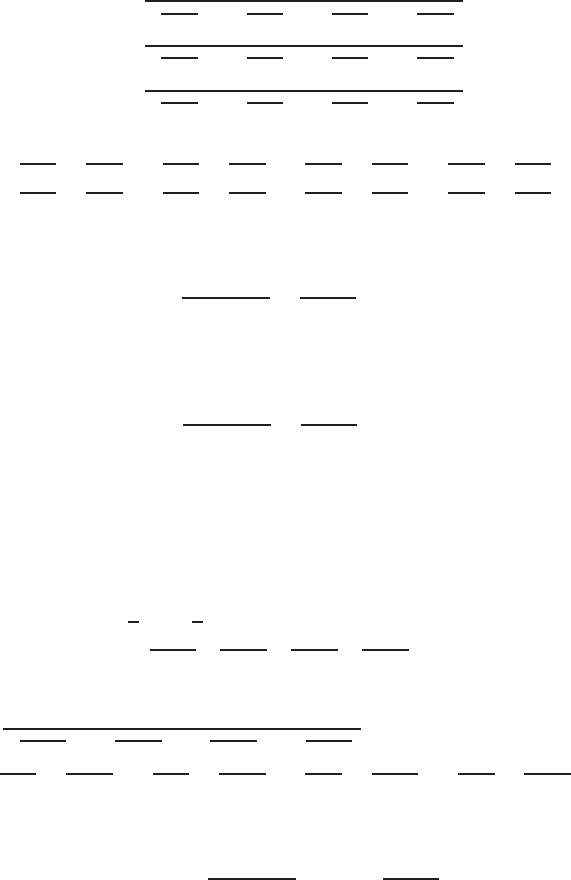
1262 Chapter Thirteen /SOLUTIONS
2. (a) Since the vectors ~a 1, . . . ,~a 4show the square roots of the relative frequencies of the alleles, and the
relative frequencies in a population add to 1, we have
k~a 2k=q√0.102+√0.092+√0.122+√0.692= 1
k~a 3k=q√0.212+√0.072+√0.062+√0.662= 1
k~a 4k=q√0.222+√0.002+√0.212+√0.572= 1
~a 2·~
a3=√0.10 ·√0.21 + √0.09 ·√0.07 + √0.12 ·√0.06 + √0.69 ·√0.66 = 0.9840
~a 3·~a 4=√0.21 ·√0.22 + √0.07 ·√0.00 + √0.06 ·√0.21 + √0.66 ·√0.57 = 0.9405.
The distance between the English and the Bantus is given by θwhere
cos θ=~a 2·~
a3
k~a 2kk~a 3k=0.9840
1·1= 0.9840
so θ= 10.3o.
The distance between the English and the Koreans is given by φwhere
cos φ=~a 3·~
a4
k~a 3kk~a 4k=0.9405
1·1= 0.9405
so φ≈19.9o. Hence the English are genetically closer to the Bantus than to the Koreans.
(b) Let ~
f1be the 4-vector showing the relative frequencies of the alleles in the Eskimo population. Let ~
f2,
~
f3,~
f4be the corresponding vectors for the Bantu, English, and Korean populations, respectively. Let ~
f5
be the 4-vector for the relative frequencies for the half Eskimo, half Bantu population, and let ~a 5be the
4-vector for the square roots of the relative frequencies . So
~
f5=1
2~
f1+1
2~
f2= (0.195,0.045,0.075,0.685)
~a 5= (√0.195,√0.045,√0.075,√0.685).
Then
k~a 5k=q√0.1952+√0.0452+√0.0752+√0.6852= 1
~a 3·~a 5=√0.21 ·√0.195 + √0.07 ·√0.045 + √0.06 ·√0.075 + √0.66 ·√0.685 = 0.9980.
So the distance between the English population and the half Eskimo, half Bantu population is
θ= arccos ~a 3·~
a5
k~a 3kk~a 5k= arccos 0.9980
1·1
= arccos 0.9980 = 3.6o.
Since 3.6<10.3, the English are closer to the Bantu/Eskimo mix than to the Bantu alone.
(c) Suppose that xis the fraction of the population that is Eskimo, where 0≤x≤1. Then (1 −x)is the
fraction that is Bantu. (For example, x= 0.5,in part (b).) Let ~
f6be the 4-vector of relative frequencies
and ~a 6the 4-vector of square roots of relative frequencies for a population that is xEskimo and (1 −x)
Bantu. We have
~
f6=x~
f1+ (1 −x)~
f2=~
f2+x(~
f1−~
f2)
=(0.10 + 0.19x, 0.09 −0.09x, 0.12 −0.09x, 0.69 −0.01x).
Then, as before
k~a 6k= 1

PROJECTS FOR CHAPTER THIRTEEN 1263
and
~a 3·~a 6=√0.21 ·√0.10 + 0.19x+√0.07 ·√0.09 −0.09x
+√0.06 ·√0.12 −0.09x+√0.66 ·√0.69 −0.01x.
Since cos θis a decreasing function of θfor 0≤θ≤π, to minimize the angle θ= arccos ~a 3·~a 6
k~a 3kk~a 6k,
we must maximize
f(x) = ~a 3·~a 6
k~a 3kk~a 6k=~a 3·~
a6.
Using a calculator or computer, we find that the maximum of this function for 0≤x≤1is
f(0.4788) = 0.9980.
So the minimum distance of θ= arccos(0.9980) = 3.6ofrom the English occurs at a mix of about 47.88%
Eskimo and 52.12% Bantu.
3. (a) Let the forces ~
F1from bar ABon joint Aand ~
F2from AE on Abe given by
~
F1=a
~
i
~
F2=f(cos 65.38◦~
i+ sin 65.38◦~
j).
The sum of ~
F1,~
F2, and the upward supporting force at Amust be the zero vector. Hence
~
F1+~
F2+ 12500~
j=~
0
(a+fcos 65.38◦)
~
i+ (fsin 65.38◦+ 12500)~
j=~
0
a+fcos 65.38◦= 0
fsin 65.38◦+ 12500 = 0.
Solving the last two equations for fand agives
f=−12500
sin 65.38◦=−13750 lb
a=−fcos 65.38◦= 5730 lb.
There is a 5730 lb force from AB acting to the right on joint A. Since the bar is pulling the joint, AB
is under 5730 lb tension.
There is a 13750 lb force from AE acting downward on joint A. Since the bar is pushing the joint,
AE is under 13750 lb compression.
(b) Let the forces ~
G1from bar BCon joint Cand ~
G2from CD on Cbe given by
~
G1=b
~
i
~
G2=g(cos 114.62◦~
i+ sin 114.62◦~
j).
The sum of ~
G1,~
G2, and the upward supporting force at Cmust be the zero vector. Hence
~
G1+~
G2+ 17500~
j=~
0
(b+gcos 114.62◦)
~
i+ (gsin 114.62◦+ 17500)~
j=~
0
b+gcos 114.62◦= 0
gsin 114.62◦+ 17500 = 0.
Solving the last two equations for gand bgives
g=−17500
sin 114.62◦=−19250 lb
b=−gcos 114.62◦=−8020 lb.

1264 Chapter Thirteen /SOLUTIONS
There is an 8020 lb force from BC acting to the left on joint C. Since the bar is pulling the joint, BC
is under 8020 lb tension.
There is a 19250 lb force from CD acting downward on joint C. Since the bar is pushing the joint,
CD is under 19250 lb compression.
(c) Let the forces ~
H1from bar DEon joint Dand ~
H2from BD on Dbe given by
~
H1=c
~
i
~
H2=h(cos 65.38◦~
i+ sin 65.38◦~
j).
The force ~
H3from CDon Dis the opposite of force ~
G2of CD on Ccomputed in part (c). The sum of
the forces ~
H1,~
H2,~
H3and the downward force from the weight at Dmust be the zero vector. Hence
~
H1+~
H2+~
H2−20000~
j=~
0
(c+hcos 65.38◦−gcos 114.62◦)
~
i+ (hsin 63.38◦−gsin 114.62◦−20000)~
j=~
0
c+hcos 65.38◦−gcos 114.62◦= 0
hsin 63.38◦−gsin 114.62◦−20000 = 0.
Since we found gin part (b) we can solve the last two equations for hand c. We have
h=gsin 114.62◦+ 20000
sin 65.38◦= 2750 lb
c=gcos 114.62◦−hcos 65.38 = 6880 lb.
There is an 6880 lb force from DE acting to the right on joint D. Since the bar is pushing the joint,
DE is under 6880 lb compression.
There is a 2750 lb force from BD acting upward on joint D. Since the bar is pushing the joint, BD is
under 2750 lb compression.
(d) Let the force ~
Pfrom bar BE on joint Ebe given by
~
P=p(cos 114.62◦~
i+sin 114.62◦~
j).
The other forces acting on Eare −~
F2from AEcomputed in part (a), −~
H1from DE computed in
part (c), and the downward force from the weight at E. The sum of these four forces must be the zero
vector. Hence
~
P−~
F2−~
H1−10000~
j=~
0
(pcos 114.62◦−fcos 65.38◦−c)
~
i+ (psin 114.62◦−fsin 65.38◦−10000)~
j=~
0
pcos 114.62◦−fcos 65.38◦−c= 0
psin 114.62◦−fsin 65.38◦−10000 = 0.
Since we found fin part (a) and cin part (c) we can solve either of the last two equations for p. Using the
last equation, we have
p=fsin 65.38◦+ 10000
sin 114.62◦=−2750 lb
There is an 2750 lb force from BE acting downward right on joint E. Since the bar is pulling the joint,
BE is under 2750 lb tension.
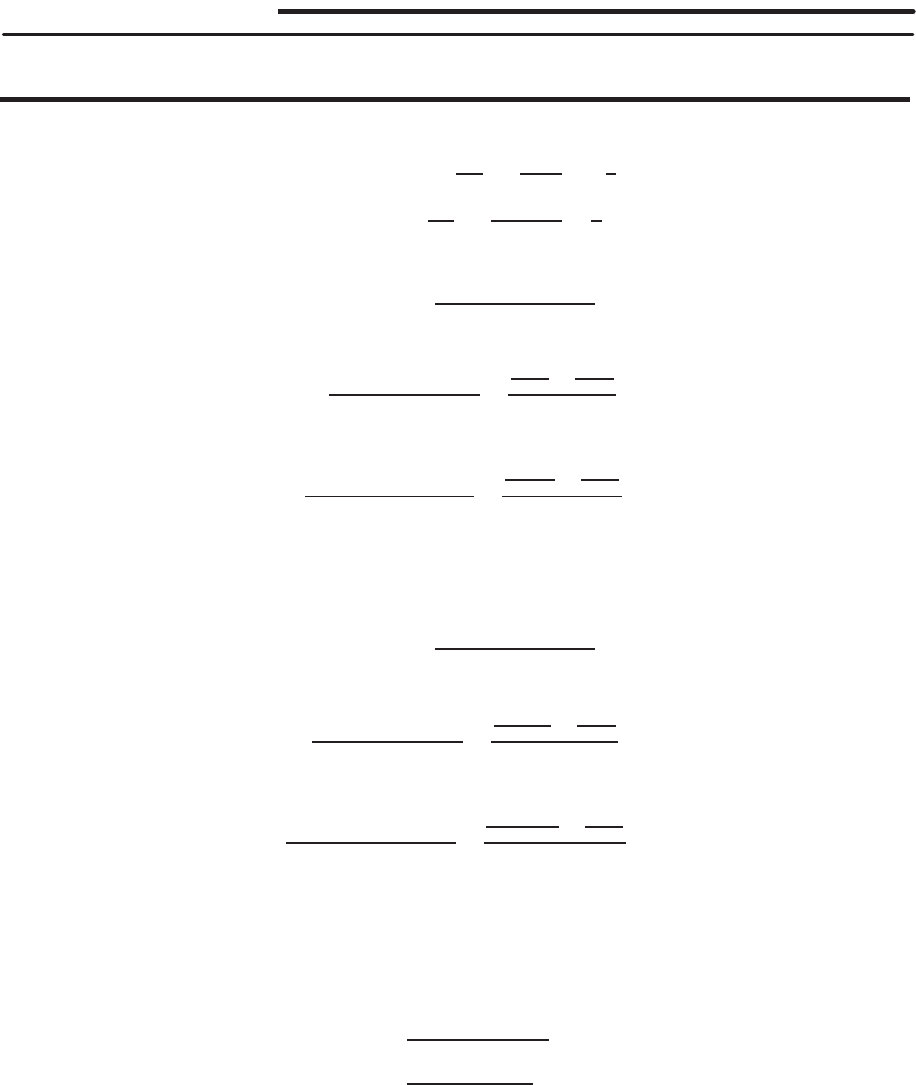
14.1 SOLUTIONS 1265
CHAPTER FOURTEEN
Solutions for Section 14.1
Exercises
1. Using difference quotients to approximate the partial derivatives
fx(3,2) ≈∆z
∆x=0−2
6−1=−2
5
fy(3,2) ≈∆z
∆y=2−(−1)
5−0=3
5.
2. If his small, then
fx(3,2) ≈f(3 + h, 2) −f(3,2)
h.
With h= 0.01, we find
fx(3,2) ≈f(3.01,2) −f(3,2)
0.01 =
3.012
(2+1) −32
(2+1)
0.01 = 2.00333.
With h= 0.0001, we get
fx(3,2) ≈f(3.0001,2) −f(3,2)
0.0001 =
3.00012
(2+1) −32
(2+1)
0.0001 = 2.0000333.
Since the difference quotient seems to be approaching 2as hgets smaller, we conclude
fx(3,2) ≈2.
To estimate fy(3,2), we use
fy(3,2) ≈f(3,2 + h)−f(3,2)
h.
With h= 0.01, we get
fy(3,2) ≈f(3,2.01) −f(3,2)
0.01 =
32
(2.01+1) −32
(2+1)
0.01 =−0.99668.
With h= 0.0001, we get
fy(3,2) ≈f(3,2.0001) −f(3,2)
0.0001 =
32
(2.0001+1) −32
(2+1)
0.0001 =−0.9999667.
Thus, it seems that the difference quotient is approaching −1, so we estimate
fy(3,2) ≈ −1.
3. Using first ∆x= 0.1and ∆y= 0.1, we have the estimates:
fx(1,3) ≈f(1.1,3) −f(1,3)
0.1
=0.0470 −0.0519
0.1=−0.0493,

1266 Chapter Fourteen /SOLUTIONS
and
fy(1,3) ≈f(1,3.1) −f(1,3)
0.1
=0.0153 −0.0519
0.1=−0.3660.
Now, using ∆x= 0.01 and ∆y= 0.01, we have the estimates:
fx(1,3) ≈f(1.01,3) −f(1,3)
0.01
=0.0514 −0.0519
0.01 =−0.0501,
and
fy(1,3) ≈f(1,3.01) −f(1,3)
0.01
=0.0483 −0.0519
0.01 =−0.3629.
4. (a) Dollars/Year.
(b) Negative. You expect to pay less for an older car.
(c) Dollars/Dollar
(d) Positive. You expect to pay more for a car that was more expensive new.
5. ∂P/∂t: The unit is dollars per month. This is the rate at which payments change as the number of months it takes to pay
off the loan changes. The sign is negative because payments decrease as the pay-off time increases.
∂P/∂r: The unit is dollars per percentage point. This is the rate at which payments change as the interest rate
changes. The sign is positive because payments increase as the interest rate increases.
6. (a) The units of ∂c/∂x are units of concentration/distance. (For example, (gm/cm3)/cm.) The practical interpretation of
∂c/∂x is the rate of change of concentration with distance as you move down the blood vessel at a fixed time. We
expect ∂c/∂x < 0because the further away you get from the point of injection, the less of the drug you would expect
to find (at a fixed time).
(b) The units of ∂c/∂t are units of concentration/time. (For example, (gm/cm3)/sec.) The practical interpretation of
∂c/∂t is the rate of change of concentration with time, as you look at a particular point in the blood vessel. We would
expect the concentration to first increase (as the drug reaches the point) and then decrease as the drug dies away.
Thus, we expect ∂c/∂t > 0for small tand ∂c/∂t < 0for large t.
7. (a) If you borrow $8000 at an interest rate of 1% per month and pay it off in 24 months, your monthly payments are
$376.59.
(b) The increase in your monthly payments for borrowing an extra dollar under the same terms as in (a) is about 4.7
cents.
(c) If you borrow the same amount of money for the same time period as in (a), but if the interest rate increases by 1%,
the increase in your monthly payments is about $44.83.
8. (a) We expect fpto be negative because if the price of the product increases, the sales usually decrease.
(b) If the price of the product is $8 per unit and if $12000 has been spent on advertising, sales increase by approximately
150 units if an additional $1000 is spent on advertising.
9. (a) Negative. As the price of beef goes up, we expect people to buy less beef and so the quantity of beef sold goes down.
If bincreases, we expect Qto decrease.
(b) Positive. As the price of chicken goes up, we expect people to buy more beef. As cincreases, we expect Qto increase.
(c) We estimate that ∆Q
∆b≈−213
1kg/dollar.
If the price of beef rose by one dollar, the store would sell approximately 213 fewer kilograms of beef.
10. Moving right from Pin the direction of increasing xincreases f, so fx(P)>0.
Moving up from Pin the direction of increasing yincreases f, so fy(P)>0.
11. Moving right from Qin the direction of increasing xincreases f, so fx(Q)>0.
Moving up from Qin the direction of increasing ydecreases f, so fy(Q)<0.
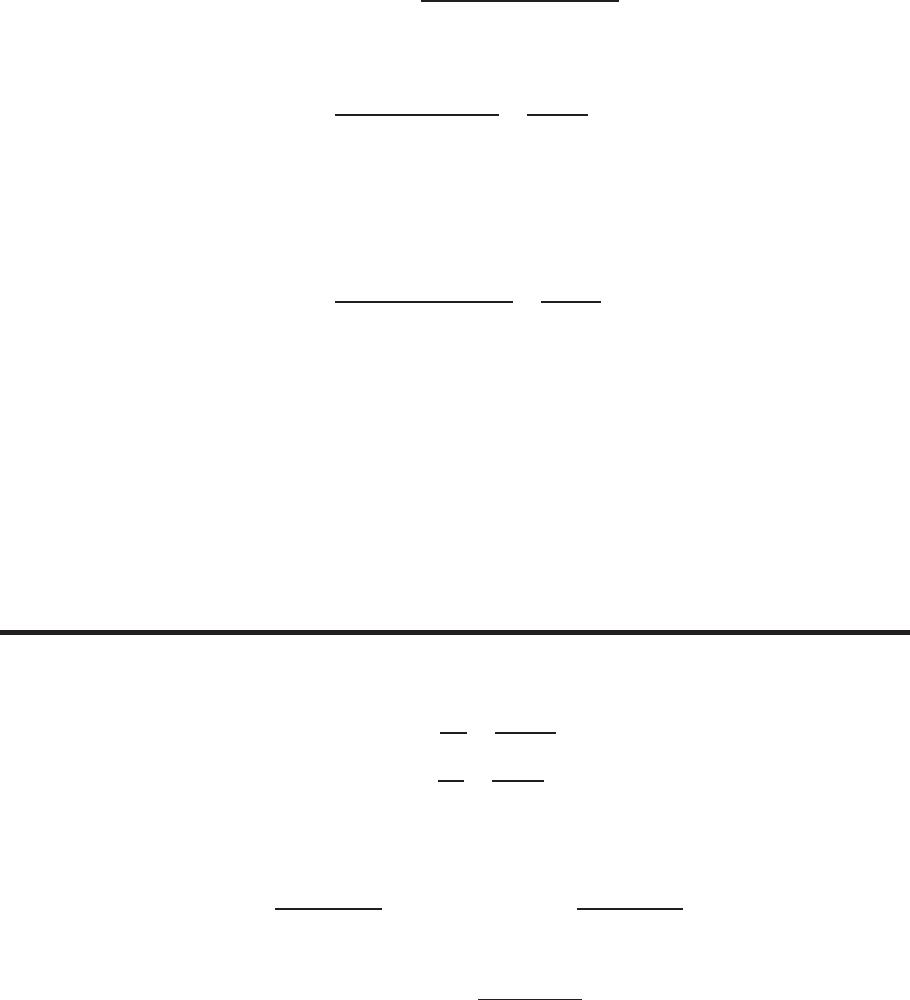
14.1 SOLUTIONS 1267
12. Moving right from Rin the direction of increasing xdecreases f, so fx(R)<0.
Moving up from Rin the direction of increasing ydecreases f, so fy(R)<0.
13. Moving right from Sin the direction of increasing xdecreases f, so fx(S)<0.
Moving up from Sin the direction of increasing yincreases f, so fy(S)>0.
14. For fw(10,25) we get
fw(10,25) ≈f(10 + h, 25) −f(10,25)
h.
Choosing h= 5 and reading values from Table 12.2 on page 672 of the text, we get
fw(10,25) ≈f(15,25) −f(10,25)
5=13 −15
5=−0.4◦F/mph
This means that when the wind speed is 10 mph and the true temperature is 25◦F, as the wind speed increases from
10 mph by 1mph we feel an approximately 0.4◦F drop in temperature. This rate is negative because the temperature you
feel drops as the wind speed increases.
15. Using a difference quotient with h= 5, we get
fT(5,20) ≈f(5,20 + 5) −f(5,20)
5=19 −13
5= 1.2◦F/◦F.
This means that when the wind speed is 5mph and the true temperature is 20◦F, the apparent temperature increases by
approximately 1.2◦F for every increase of 1◦F in the true temperature. This rate is positive because the true temperature
you feel increases as true temperature increases.
16. Since the average rate of change of the temperature adjusted for wind-chill is about −0.8(drops by 0.8◦F), with every 1
mph increase in wind speed from 5mph to 10 mph, when the true temperature stays constant at 20◦F, we know that
fw(5,20) ≈ −0.8.
Problems
17. The values of zincrease as we move in the direction of increasing x-values, so fxis positive. The values of zdecrease as
we move in the direction of increasing y-values, so fyis negative. We see in the contour diagram that f(2,1) = 10. We
estimate the partial derivatives:
fx(2,1) ≈∆z
∆x=14 −10
4−2= 2,
fy(2,1) ≈∆z
∆y=6−10
2−1=−4.
18. From the contour diagram, approximate values of fat nearby x-values are f(3,5) = 10,f(6.3,5) = 8,f(0.4,5) = 12.
Difference quotient approximations are
fx(3,5) ≈f(6.3) −f(3)
6.3−3=−0.61 fx(3,5) ≈f(0.4) −f(3)
0.4−3=−0.77.
Another reasonable approximation is obtained by averaging the two difference quotients:
fx(3,5) ≈Average =−0.61 −0.77
2=−0.7.
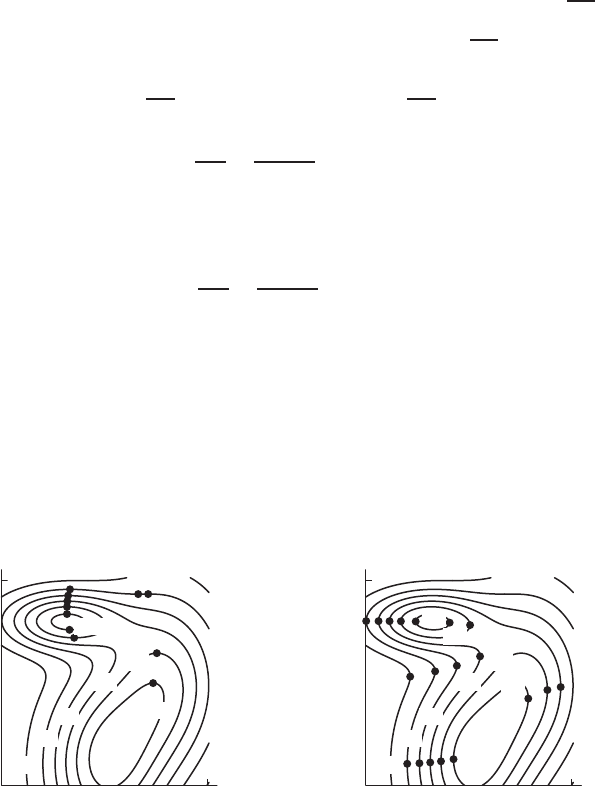
1268 Chapter Fourteen /SOLUTIONS
19. The partial derivative, ∂Q/∂b is the rate of change of the quantity of beef purchased with respect to the price of beef,
when the price of chicken stays constant. If the price of beef increases and the price of chicken stays the same, we expect
consumers to buy less beef and more chicken. Thus when bincreases, we expect Qto decrease, so ∂Q/∂b < 0.
On the other hand, ∂Q/∂c is the rate of change of the quantity of beef purchased with respect to the price of chicken,
when the price of beef stays constant. An increase in the price of chicken is likely to cause consumers to buy less chicken
and more beef. Thus when cincreases, we expect Qto increase, so ∂Q/∂c > 0.
20. (a) An increase in the price of a new car will decrease the number of cars bought annually. Thus ∂q1
∂x <0. Similarly, an
increase in the price of gasoline will decrease the amount of gas sold, implying ∂q2
∂y <0.
(b) Since the demands for a car and gas complement each other, an increase in the price of gasoline will decrease the
total number of cars bought. Thus ∂q1
∂y <0. Similarly, we may expect ∂q2
∂x <0.
21. We have
ft(18,6) ≈∆P
∆t=90 −93
20 −18 =−1.5percent/month.
Eighteen months after rats are exposed to a formaldehyde concentration of 6 ppm, the percent of rats surviving is de-
creasing at a rate of about 1.5per month. In other words, during the eighteenth month, an additional 1.5% of the rats
die.
We have
fc(18,6) ≈∆P
∆c=82 −93
15 −6=−1.22 percent/ppm.
If the original concentration increases by 1 ppm, the percent surviving after 18 months decreases by about 1.22.
22. The fact that fx(P)>0tells us that the values of the function on the contours increase as we move to the right in
Figure 14.3 past the point P. Thus, the values of the function on the contours
(a) Decrease as we move upward past P. Thus fy(P)<0.
(b) Decrease as we move upward past Q(since Qand Pare on the same contour line.) Thus fy(Q)<0.
(c) Decrease as we move to the right past Q. Thus fx(Q)<0
23. (a) The partial derivative gx(x, y)is zero at points where a contour has a horizontal tangent line. See Figure 14.1.
(b) The partial derivative gy(x, y)is zero at points where a contour has a vertical tangent line. See Figure 14.2.
10
10
10
20
30
40
50
60
5060
x
y
Figure 14.1
10
10
10
20
30
40
50
60
50
60
x
y
Figure 14.2
24. (a) (i) Near A, the value of zincreases as xincreases, so fx(A)>0.
(ii) Near A, the value of zdecreases as yincreases, so fy(A)<0.
(b) fx(P)changes from positive to negative as Pmoves from Ato Balong a straight line, because after Pcrosses the
y-axis, zdecreases as xincreases near P.
fy(P)does not change sign as Pmoves from Ato Balong a straight line; it is negative along AB.
25. (a) For points near the point (0,5,3), moving in the positive xdirection, the surface is sloping down and the function is
decreasing. Thus, fx(0,5) <0.
(b) Moving in the positive ydirection near this point the surface slopes up as the function increases, so fy(0,5) >0.

14.1 SOLUTIONS 1269
26. Locating the points (3,2, f(3,2)) and (1,2, f(1,2)) on the graph in Figure 14.3 we see that fx(1,2) and fx(3,2) are
both negative with fx(1,2) < fx(3,2). Similarly, fy(3,2) and fy(1,2) are both positive with fy(3,2) < fy(1,2).
Therefore,
fx(1,2) < fx(3,2) <0< fy(3,2) < fy(1,2).
xy
z
✲
(3,2, f(3,2))
✲
(1,2, f(1,2))
Figure 14.3
27. (a) Estimate ∂P/∂r and ∂P/∂L by using difference quotients and reading values of Pfrom the graph:
∂P
∂r (8,4000) ≈P(16,4000) −P(8,4000)
16 −8
=100 −80
8= 2.5,
and
∂P
∂L ≈P(8,5000) −P(8,4000)
5000 −4000
=100 −80
1000 = 0.02.
Pr(8,4000) ≈2.5means that at an interest rate of 8% and a loan amount of $4000 the monthly payment increases
by approximately $2.50 for every one percent increase of the interest rate. PL(8,4000) ≈0.02 means the monthly
payment increases by approximately $0.02 for every $1 increase in the loan amount at an 8% rate and a loan amount
of $4000.
(b) Using difference quotients and reading from the graph
∂P
∂r (8,6000) ≈P(14,6000) −P(8,6000)
14 −8
=140 −120
6= 3.33,
and
∂P
∂L (8,6000) ≈P(8,7000) −P(8,6000)
7000 −6000
=140 −120
1000 = 0.02.
Again, we see that the monthly payment increases with increases in interest rate and loan amount. The interest rate
is r= 8% as in part (a), but here the loan amount is L= $6000. Since PL(8,4000) ≈PL(8,6000), the increase
in monthly payment per unit increase in loan amount remains the same as in part a). However, in this case, the effect
of the interest rate is different: here the monthly payment increases by approximately $3.33 for every one percent
increase of interest rate at r= 8% and loan amount of $6000.
(c)
∂P
∂r (13,7000) ≈P(19,7000) −P(13,7000)
19 −13
=180 −160
6= 3.33,

1270 Chapter Fourteen /SOLUTIONS
and
∂P
∂L (13,7000) ≈P(13,8000) −P(13,7000)
8000 −7000
=180 −160
1000 = 0.02.
The figures show that the rates of change of the monthly payment with respect to the interest rate and loan amount
are roughly the same for (r, L) = (8,6000) and (r, L) = (13,7000).
28. The sign of ∂f /∂P1tells you whether f(the number of people who ride the bus) increases or decreases when P1is
increased. Since P1is the price of taking the bus, as it increases, fshould decrease. This is because fewer people will be
willing to pay the higher price, and more people will choose to ride the train. On the other hand, the sign of ∂f
∂P2
tells you
the change in fas P2increases. Since P2is the cost of riding the train, as it increases, fshould increase. This is because
fewer people will be willing to pay the higher fares for the train, and more people will choose to ride the bus.
Therefore, ∂f
∂P1
<0and ∂f
∂P2
>0.
29. (i) Statement (i) indicates that, as vincreases at a constant temperature, Wwill decrease. Therefore, fv(T, v)<0,and
so statement (i) matches formula (c).
(ii) Statement (ii) indicates that, as Tincreases at a constant riding speed, Walso increases. Therefore, fT(T, v)>0,
and so statement (ii) matches formula (a).
We now see that formula (c) does not match either given statement. In words, the statement “f(0, v)≤0” is saying
that, if the air temperature is held constant at 0◦F then, no matter what speed you are biking at, you will feel at least as
cold as 0◦F.
30. (a) Estimating T(x, t)from the figure in the text at x= 15,t= 20 gives
∂T
∂x (15,20) ≈T(23,20) −T(15,20)
23 −15 =20 −23
8=−3
8◦C per m,
∂T
∂t (15,20) ≈T(15,25) −T(15,20)
25 −20 =25 −23
5=2
5◦C per min.
At 15 m from heater at time t= 20 min, the room temperature decreases by approximately 3/8◦C per meter and
increases by approximately 2/5◦C per minute.
(b) We have the estimates,
∂T
∂x (5,12) ≈T(7,12) −T(5,12)
7−5=25 −27
2=−1◦C per m,
∂T
∂t (5,12) ≈T(5,40) −T(5,12)
40 −12 =30 −27
28 =3
28 ◦C per min.
At x= 5,t= 12 the temperature decreases by approximately 1◦C per meter and increases by approximately 3/28◦C
per minute.
31. The quantity HT(10,0.1) is approximated by a difference quotient. The first partial derivative with respect to Tis ap-
proximated by
HT(10,0.1) ≈H(10 + ∆T, 0.1) −H(10,0.1)
∆Tfor small ∆T .
We are free to choose ∆T. If we take H(10,0.1) = 110 and H(20,0.1) = 100, we get the approximation
HT(10,0.1) ≈H(20,0.1) −H(10,0.1)
10 =95 −120
10 =−2.5.
(Note that you may get a different answer if you read different values from the graph.) The geometric meaning of
the partial derivative HT(10,0.01) that we just approximated is the slope of the curve shown in the figure in the text
corresponding to w= 0.1at the point where T= 10. In practical terms, we have found that for fog at 10◦C containing
0.1g water per m3of fog, a 1◦C increase in temperature will reduce the heat requirement for dissipating the fog by about
1 calories per cubic meter of fog.
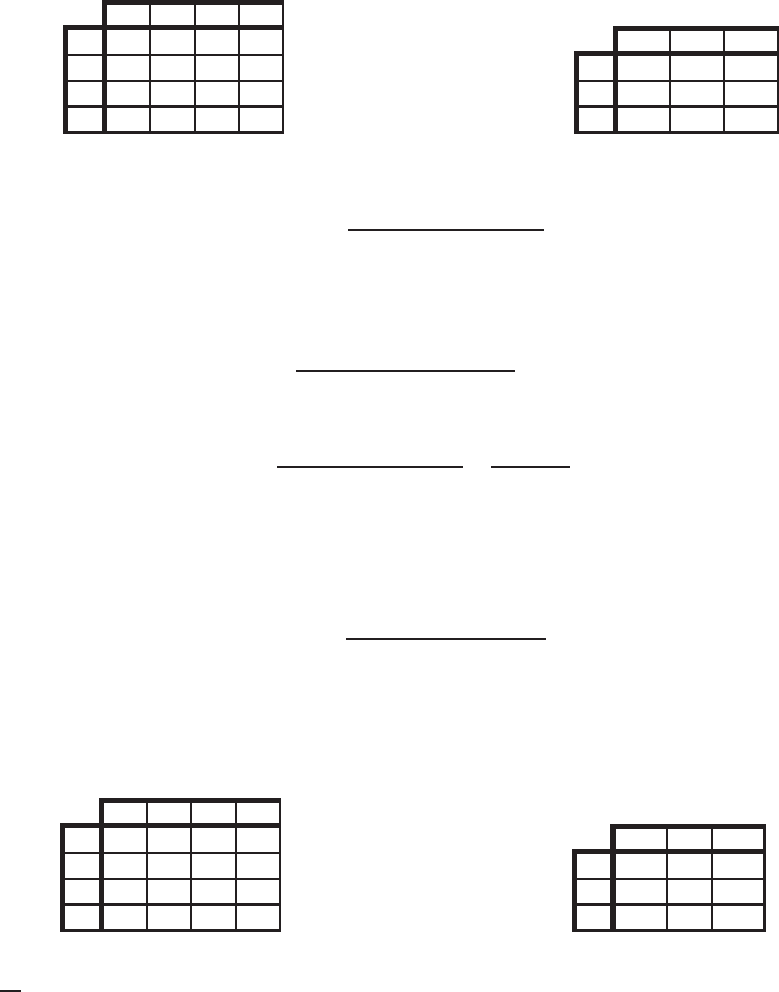
14.1 SOLUTIONS 1271
32. Reading values of Hfrom the graph gives Table 14.1. In order to compute HT(T, w)at T= 30, it is useful to have
values of H(T, w)for T= 40◦C. The column corresponding to w= 0.4is not used in this problem.
Table 14.1
Estimated values of
H(T, w)(in calories/meter3)
T(◦C)
w(gm/m3)
0.1 0.2 0.3 0.4
10 110 240 330 450
20 100 180 260 350
30 70 150 220 300
40 65 140 200 270
Table 14.2
Estimated values of
HT(T, w)(in calories/meter3/◦C)
T(◦C)
w(gm/m3)
0.1 0.2 0.3
10 −1.0−6.0−7.0
20 −3.0−3.0−4.0
30 −0.5−1.0−2.0
The estimates for HT(T, w)in Table 14.2 are now computed using the formula
HT(T, w)≈H(T+ 10, w)−H(T, w)
10 .
33. Values of Hfrom the graph are given in Table 14.3. In order to compute Hw(T, w)for w= 0.3, it is useful to have the
column corresponding to w= 0.4. The row corresponding to T= 40 is not used in this problem. The partial derivative
Hw(T, w)can be approximated by
Hw(10,0.1) ≈H(10,0.1 + h)−H(10,0.1)
hfor small h.
We choose h= 0.1because we can read off a value for H(10,0.2) from the graph. If we take H(10,0.2) = 240, we get
the approximation
Hw(10,0.1) ≈H(10,0.2) −H(10,0.1)
0.1=240 −110
0.1= 1300.
In practical terms, we have found that for fog at 10◦C containing 0.1 g/m3of water, an increase in the water content of
the fog will increase the heat requirement for dissipating the fog at the rate given by Hw(10,0.1). Specifically, a 1 g/m3
increase in the water content will increase the heat required to dissipate the fog by about 1300 calories per cubic meter of
fog.
Wetter fog is harder to dissipate. Other values of Hw(T, w)in Table 14.4 are computed using the formula
Hw(T, w)≈H(T, w + 0.1) −H(T, w)
0.1,
where we have used Table 14.3 to evaluate H.
Table 14.3
Estimated values of
H(T, w)(in calories/meter3)
T(◦C)
w(gm/m3)
0.1 0.2 0.3 0.4
10 110 240 330 450
20 100 180 260 350
30 70 150 220 300
40 65 140 200 270
Table 14.4
Table of values of Hw(T, w)(in cal/gm)
T(◦C)
w(gm/m3)
0.1 0.2 0.3
10 1300 900 1200
20 800 800 900
30 800 700 800
34. (a) ∂p
∂c =fc(c, s) = rate of change in blood pressure as cardiac output increases while systemic vascular resistance
remains constant.
(b) Suppose that p=kcs. Note that c(cardiac output), a volume, s(SVR), a resistance, and p, a pressure, must all be
positive. Thus kmust be positive, and our level curves should be confined to the first quadrant. Several level curves
are shown in Figure 14.4. Each level curve represents a different blood pressure level. Each point on a given curve is
a combination of cardiac output and SVR that results in the blood pressure associated with that curve.
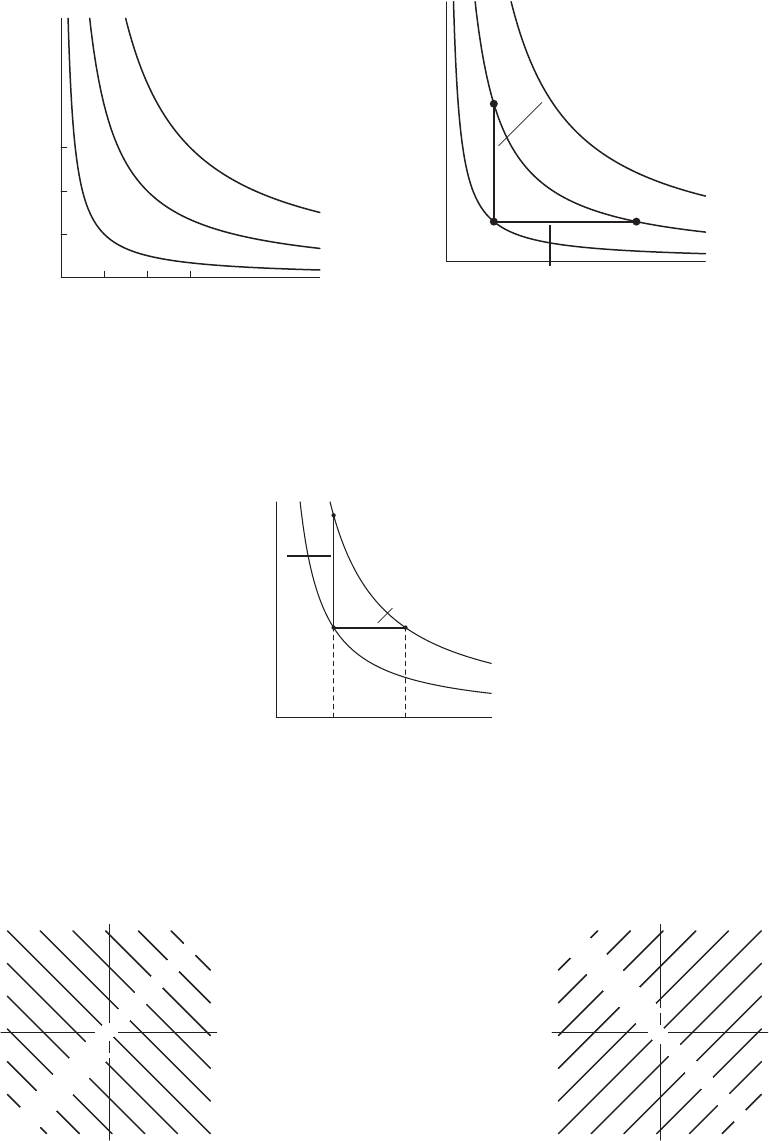
1272 Chapter Fourteen /SOLUTIONS
1 2 3
1
2
3
p= 9k
p= 4k
p= 1k
c(vol)
s(SVR)
Figure 14.4
A
B
❄✲
✠
After
Nitroglycerine,
SVR drops
After Dopamine,
cardiac output increases
✻
c(vol)
s(SVR)
Figure 14.5
(c) Point Bin Figure 14.5 shows that if the two doses are correct, the changes in pressure will cancel. The patient’s
cardiac output will have increased and his SVR will have decreased, but his blood pressure won’t have changed.
(d) At point Fin Figure 14.6, the patient’s blood pressure is normalized, but his/her cardiac output has dropped and his
SVR is up.
c(vol)
s(SVR)
c2c1
D
E
F
✛
✻
✲
resident
gives drug
increasing
SVR
✠
during heart attack
cardiac output drops
Figure 14.6
Note: c1and c2are the cardiac outputs before and after the heart attack, respectively.
35. (a) Since fx>0, the values on the contours increase as you move to the right. Since fy>0, the values on the contours
increase as you move upward. See Figure 14.7.
−5
−4
−3
−2
−1
0
1
2
3
4
5
x
y
Figure 14.7
:fx>0and fy>0
−5
−4
−3
−2
−1
0
1
2
3
4
5
x
y
Figure 14.8
:fx>0and fy<0
(b) Since fx>0, the values on the contours increase as you move to the right. Since fy<0, the values on the contours
decrease as you move upward. See Figure 14.8.
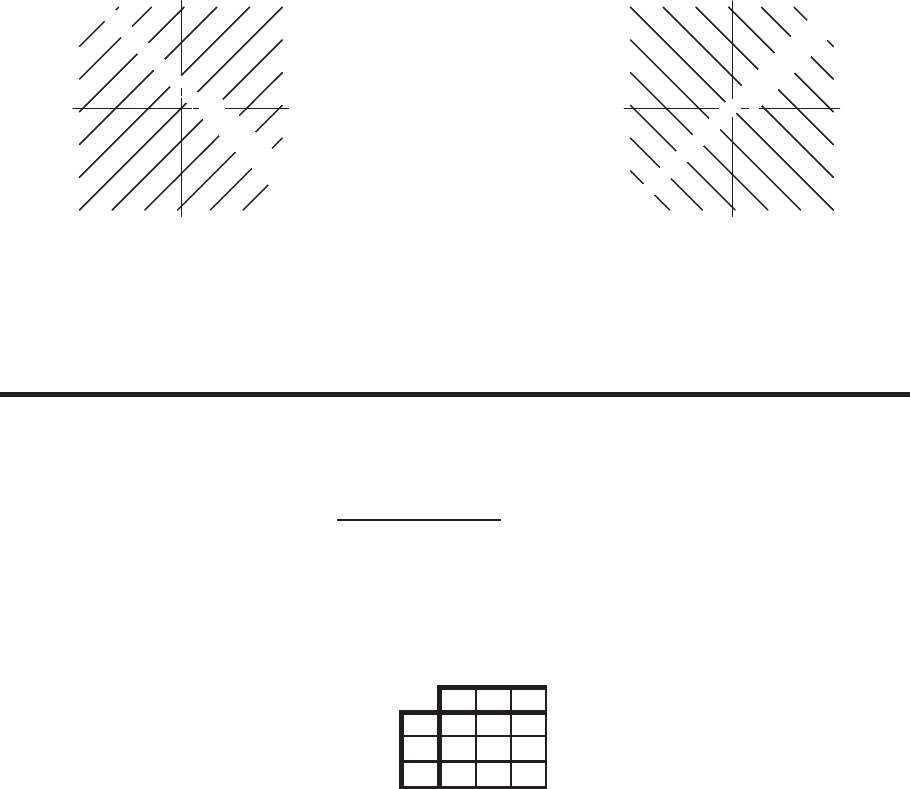
14.1 SOLUTIONS 1273
(c) Since fx<0, the values on the contours decrease as you move to the right. Since fy>0, the values on the contours
increase as you move upward. See Figure 14.9.
−5
−4
−3
−2
−1
0
1
2
3
4
5
x
y
Figure 14.9
:fx<0and fy>0
5
4
3
2
1
0
−1
−2
−3
−4
−5
x
y
Figure 14.10
:fx<0and fy<0
(d) Since fx<0, the values on the contours decrease as you move to the right. Since fy<0, the values on the contours
decrease as you move upward. See Figure 14.10.
Strengthen Your Understanding
36. The units of ∂f /∂x and ∂f/∂y are the same if xand yhave the same units. They are different if xand yhave different
units.
37. If a formula for f(x, y)does not contain yexplicitly, then all difference quotients are zero:
f(x, y +h)−f(x, y)
h= 0 for h6= 0.
Hence the partial derivative with respect to yis defined and fy(x, y) = 0.
38. Since fx<0, the slope of fin the x-direction is negative. Since fy>0, the slope of fin the y-direction is positive. A
possible table of a linear function satisfying these conditions is:
x
y
0 5 10
0 50 52 54
10 40 42 44
20 30 32 34
39. One type of function that would satisfy the given condition would be one with fx= 4 and fy=−1. A function with
these partial derivatives is f(x, y) = 4x−y.
40. True. This is the instantaneous rate of change of fin the x-direction at the point (10,20).
41. False. The graph of fis a paraboloid or bowl-shape, with lowest point at the origin and opening in the positive z-direction.
At (1,1) the function is increasing in the y-direction, so fy(1,1) >0.
42. True. Slicing the graph of fin the xz-plane yields a semicircle, and at the point x= 0 this semicircle has a horizontal
tangent line. Thus fx(0,0) = 0. A similar argument shows that fy(0,0) = 0.
43. False. The units of ∂P /∂V are the units of Pdivided by the units of V, which gives (grams/cm3)/cm3, or grams/cm6.
44. True. The property fx(a, b)>0means that fincreases in the positive x-direction near (a, b), so fmust decrease in the
negative x-direction near (a, b).
45. True. When we fix s=k, then g(r, k) = r2+k, whose graph is a parabola. Since this parabola is concave up, we know
its slope increases as rincreases.
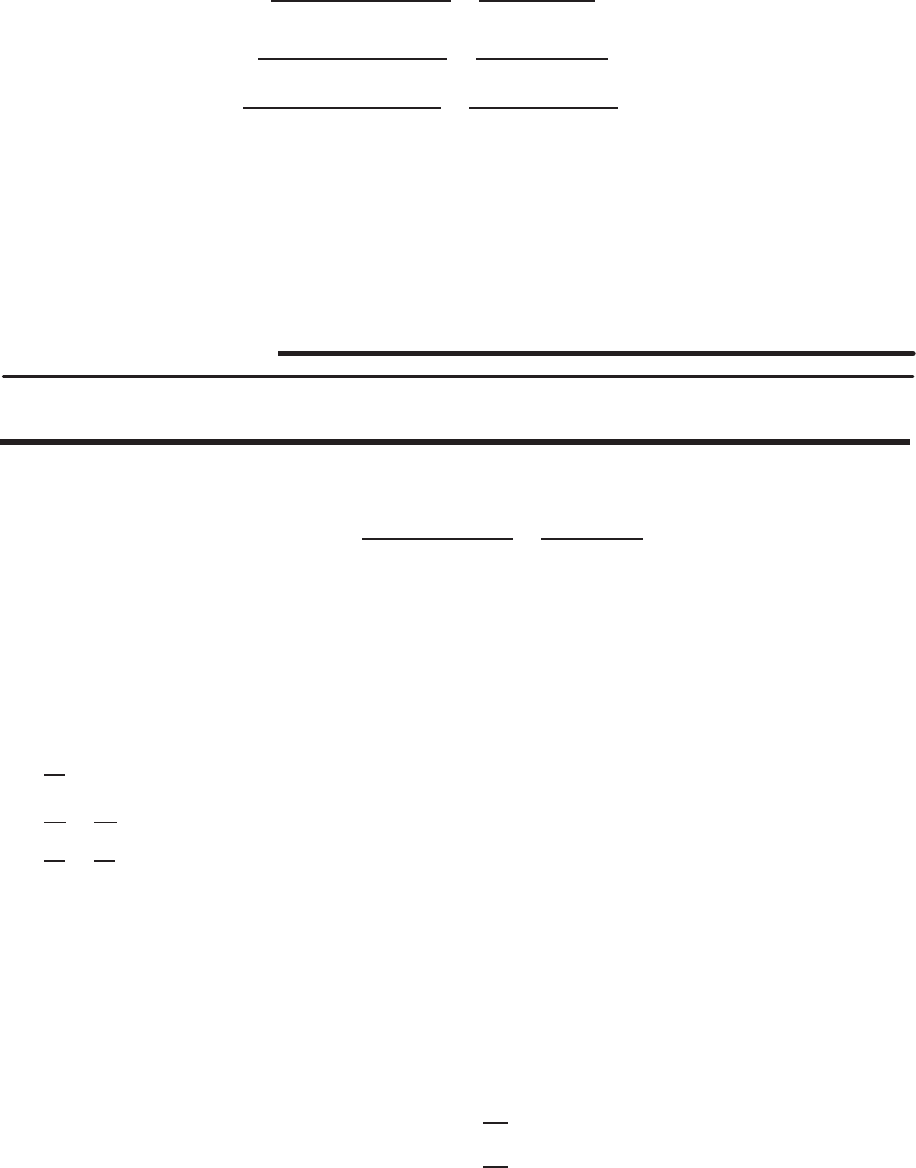
1274 Chapter Fourteen /SOLUTIONS
46. True. Using difference quotients to approximate gu(1,1), we find that
g(1 + 0.01,1) −g(1,1)
0.01 =(2.01)1.01 −21
0.01 ≈2.40816
g(1 + 0.001,1) −g(1,1)
0.001 =(2.001)1.001 −21
0.001 ≈2.38847
g(1 + 0.0001,1) −g(1,1)
0.0001 =(2.0001)1.0001 −21
0.0001 ≈2.38651.
47. False. Increasing m, the number of miles on the engine, for fixed dgenerally lowers the price of the car, so ∂P /∂m < 0.
A higher original cost, d, with fixed musually gives an increased sales price, so ∂P /∂d > 0.
48. True. A function with constant fx(x, y)and fy(x, y)has constant x-slope and constant y-slope, and therefore has a graph
which is a plane.
49. False. Having zero for the xand ypartial derivatives at a single point means only that cross-sections through the graph
have horizontal tangents at that point. For example, f(x, y) = x2+y2has fx(0,0) = fy(0,0) = 0, but fis not constant.
Solutions for Section 14.2
Exercises
1. (a) Make a difference quotient using the two points (3,2) and (3,2.01) that have the same x-coordinate 3 but whose
y-coordinates differ by 0.01. We have
fy(3,2) ≈f(3,2.01) −f(3,2)
2.01 −2=28.0701 −28
0.01 = 7.01.
(b) Differentiating gives fy(x, y) = x+ 2y, so fy(3,2) = 3 + 2 ·2 = 7.
2. fx(x, y) = 10xy3+ 8y2−6xand fy(x, y) = 15x2y2+ 16xy.
3. We have
fx(x, y) = 3x2+ 6xy and fy(x, y) = 3x2−4y,
so
fx(1,2) = 15 and fy(1,2) = −5.
4. ∂
∂y (3x5y7−32x4y3+ 5xy) = 21x5y6−96x4y2+ 5x
5. ∂z
∂x =∂
∂x (x2+x−y)7= 7(x2+x−y)6(2x+ 1) = (14x+ 7)(x2+x−y)6.
∂z
∂y =∂
∂y (x2+x−y)7=−7(x2+x−y)6.
6. Thinking of A,α,βas constants,
fx= (α+β)Aαxα+β−1y1−α−β
fy= (1 −α−β)Aαxα+βy−α−β.
7. The differentiation is easier if we rewrite fusing the rules of logarithms:
f(x, y) = 0.6 ln x+ 0.4 ln y.
Then
fx=0.6
x
fy=0.4
y.

14.2 SOLUTIONS 1275
8. zx=1
2ay (−2) 1
x3+15x4abc
y=−1
ax3y+15abcx4
y=15a2bcx7−1
ax3y
9. zx= 2xy + 10x4y
10. Vr=2
3πrh
11. ∂
∂T 2πr
T=−2πr
T2
12. ∂
∂x (a√x) = a·1
2x−1/2=a
2√x
13. ∂
∂x (xe√xy) = e√xy +xe√xy ·1
2(xy)−1/2y=e√xy (1 + xy
2√xy ) = e√xy (1 + √xy
2)
14. We have ∂
∂t esin(x+ct)=esin(x+ct)·cos(x+ct)·c.
15. Fm=g
16. av=2v
r
17. ∂A
∂h =1
2(a+b)
18. ∂
∂m 1
2mv2=1
2v2
19. ∂
∂B 1
u0
B2=2B
u0
20. ∂
∂r 2πr
v=2π
v
21. Fv=2mv
r
22. ∂
∂v0
(v0+at) = 1 + 0 = 1
23. ∂F
∂m2
=Gm1
r2
24. With aconstant, we have ∂
∂x 1
ae−x2/a2=1
ae−x2/a2−2x
a2=−2x
a3e−x2/a2.
25. With xconstant, we use the product and chain rules
∂
∂a 1
ae−x2/a2=−1
a2e−x2/a2+1
ae−x2/a22x2
a3=−e−x2/a2
a4a2−2x2.
26. ∂f
∂x =∂
∂x [exy (ln y)] = ∂exy
∂x ln y=yexy(ln y).
27. ∂
∂t (v0t+1
2at2) = v0+1
2·2at =v0+at
28. Since we take the partial derivative with respect to θ, we think of πand φas constant. Thus,
∂
∂θ (cos (πθφ) + ln(θ2+φ)) = cos(πθφ)·πφ +1
θ2+φ·2θ.
29. ∂
∂M 2πr3/2
√GM = 2πr3/2(−1
2)(GM)−3/2(G) = −πr3/2·G
GM√GM =−πr3/2
M√GM
30. fa=easin(a+b) + eacos(a+b)
31. zx= cos(5x3y−3xy2)·(15x2y−3y2) = (15x2y−3y2) cos(5x3y−3xy2)
32. gx(x, y) = ∂
∂x ln(yexy) = (yexy)−1∂
∂x (yexy ) = (yexy)−1·y∂
∂x (exy) = (yexy)−1·y·y·exy =y
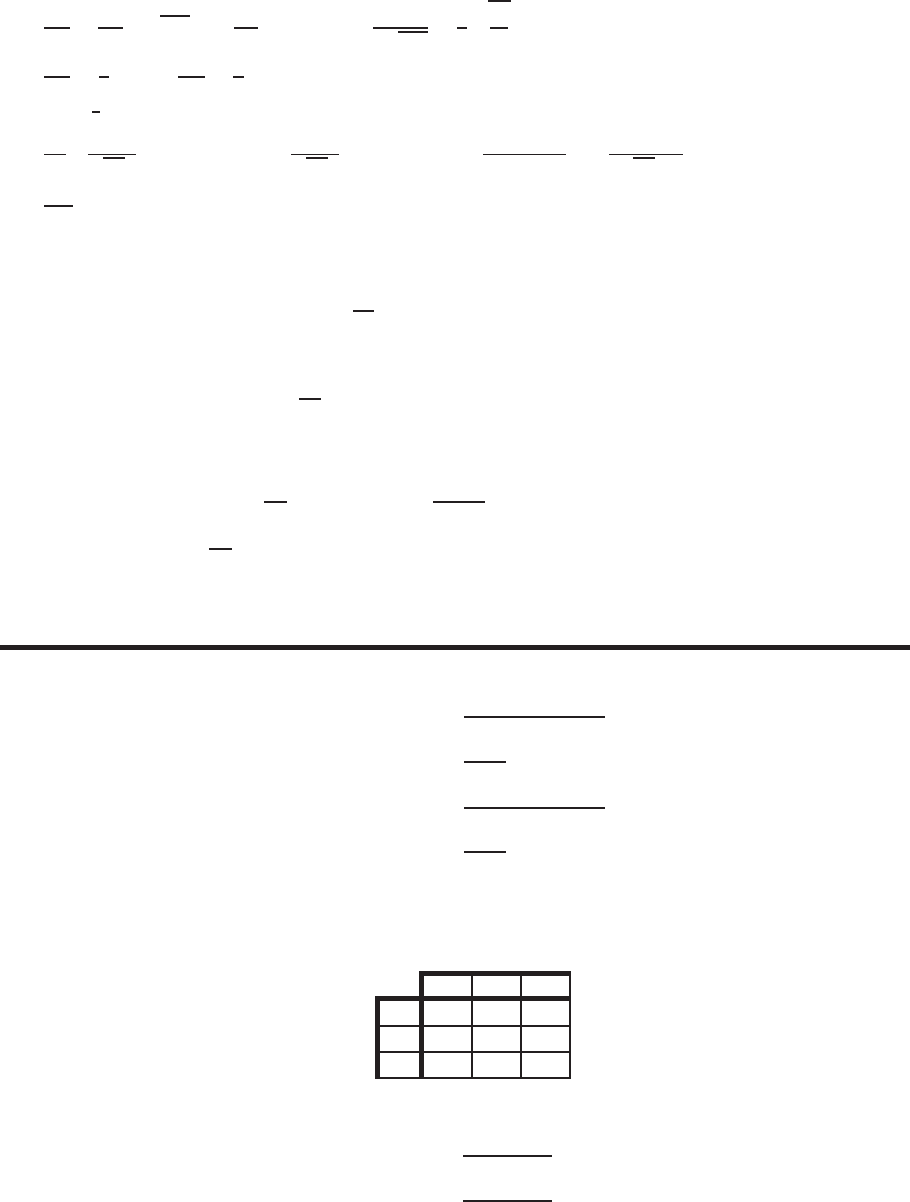
1276 Chapter Fourteen /SOLUTIONS
33. ∂F
∂L =∂
∂L 3√LK= 3 ∂
∂L (LK)1/2=3K
2√LK =3
2rK
L.
34. ∂V
∂r =8
3πrh and ∂V
∂h =4
3πr2.
35. uE=1
2ǫ0·2E+ 0 = ǫ0E
36. ∂
∂x 1
√2πσ e−(x−µ)2/(2σ2)=1
√2πσ e−(x−µ)2/(2σ2)·−2(x−µ)
2σ2=−(x−µ)
√2πσ3e−(x−µ)2/(2σ2).
37. ∂Q
∂K =cγ(a1Kb1+a2Lb2)γ−1·a1b1Kb1−1
38. zx= 7x6+yxy−1, and zy= 2yln 2 + xyln x
39. We regard xas constant and differentiate with respect to yusing the product rule:
∂z
∂y = 2ex+2ysin y+ex+2ycos y
Substituting x= 1,y= 0.5gives
∂z
∂y (1,0.5)
= 2e2sin(0.5) + e2cos(0.5) = 13.6.
40.
∂f
∂x = ln (ycos x) + x1
ycos x(−ysin x) = ln(ycos x)−xtan x
∂f
∂x (π/3,1)
= ln (cos π/3) −π/3 tan π/3≈ −2.51
Problems
41. (a) From contour diagram,
fx(2,1) ≈f(2.3,1) −f(2,1)
2.3−2
=6−5
0.3= 3.3,
fy(2,1) ≈f(2,1.4) −f(2,1)
1.4−1
=6−5
0.4= 2.5.
(b) A table of values for fis given in Table 14.5.
Table 14.5
x
y
0.9 1.0 1.1
1.9 4.42 4.61 4.82
2.0 4.81 5.00 5.21
2.1 5.22 5.41 5.62
From Table 14.5 we estimate fx(2,1) and fy(2,1) using difference quotients:
fx(2,1) ≈5.41 −5.00
2.1−2= 4.1
fy(2,1) ≈5.21 −5.00
1.1−1= 2.1.
We obtain better estimates by finer data in the table.
(c) fx(x, y) = 2x,fy(x, y) = 2y. So the true values are fx(2,1) = 4,fy(2,1) = 2.
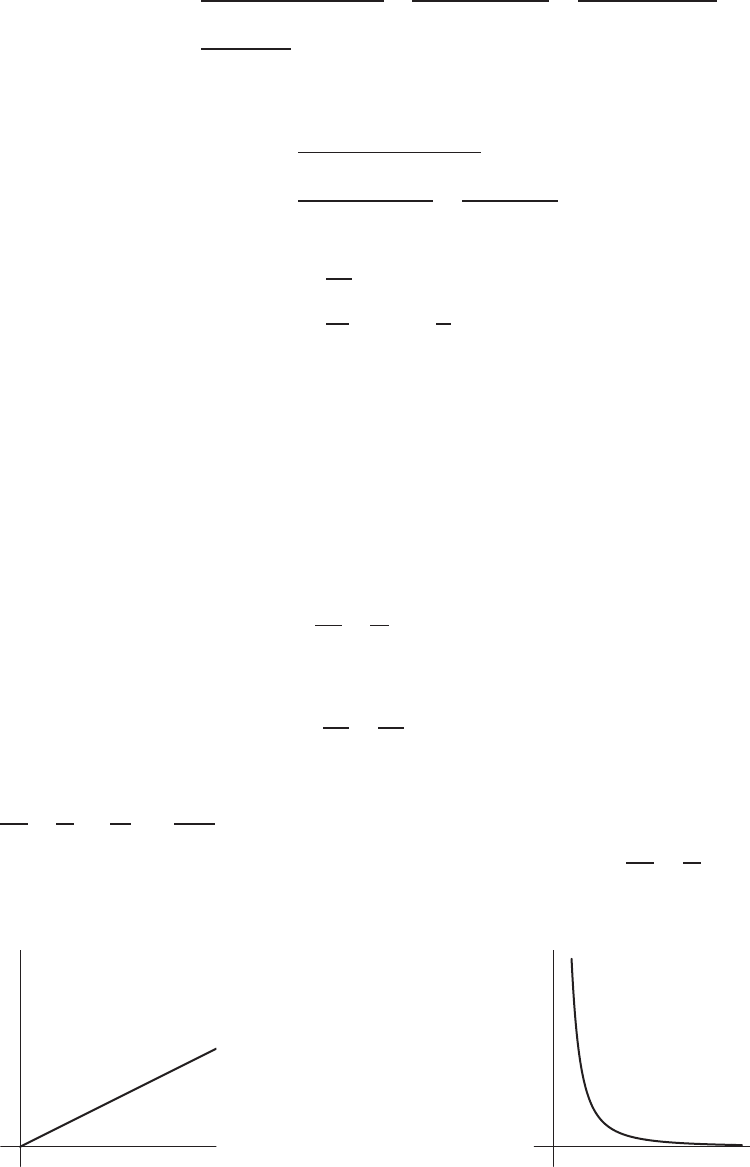
14.2 SOLUTIONS 1277
42. (a) The difference quotient for evaluating fw(2,2) is
fw(2,2) ≈f(2 + 0.01,2) −f(2,2)
h=e(2.01) ln 2 −e2 ln 2
0.01 =eln(22.01)−eln(22)
0.01
=2(2.01) −22
0.01 ≈2.78
The difference quotient for evaluating fz(2,2) is
fz(2,2) ≈f(2,2 + 0.01) −f(2,2)
h
=e2 ln(2.01) −e2 ln 2
0.01 =(2.01)2−22
0.01 = 4.01
(b) Using the derivative formulas we get
fw=∂f
∂w = ln z·ewln z=zw·ln z
fz=∂f
∂z =ewln z·w
z=w·zw−1
so
fw(2,2) = 22·ln 2 ≈2.773
fz(2,2) = 2 ·22−1= 4.
43. (a) Since ∂z/∂x = 6x−ay if the surface is sloping up at (1,2) we have 6−2a > 0, so a < 3.
(b) Since ∂z/∂y = 8y−ax, at (1,2) we have ∂z/∂y = 16 −a > 0if a < 3. Thus the surface is sloping upward in the
y-direction at (1,2).
44. (a) To calculate ∂B/∂t, we hold Pconstant and differentiate Bwith respect to t:
∂B
∂t =∂
∂t (P ert) = P rert.
In financial terms, ∂B/∂t represents the change in the amount of money in the bank as one unit of time passes by.
(b) To calculate ∂B/∂P , we hold tconstant and differentiate Bwith respect to P:
∂B
∂P =∂
∂P (P ert) = ert.
In financial terms, ∂B/∂P represents the change in the amount of money in the bank at time tas you increase the
amount of money that was initially deposited by one unit.
45. (a) ∂g
∂m =G
r2and ∂g
∂r =−2Gm
r3
(b) For constant r, the graph of gagainst mis a straight line through the origin with slope ∂g
∂m =G
r2. Thus gincreases
as mincreases, while ris constant. See Figure 14.11.
m
g
Figure 14.11
r
g
Figure 14.12
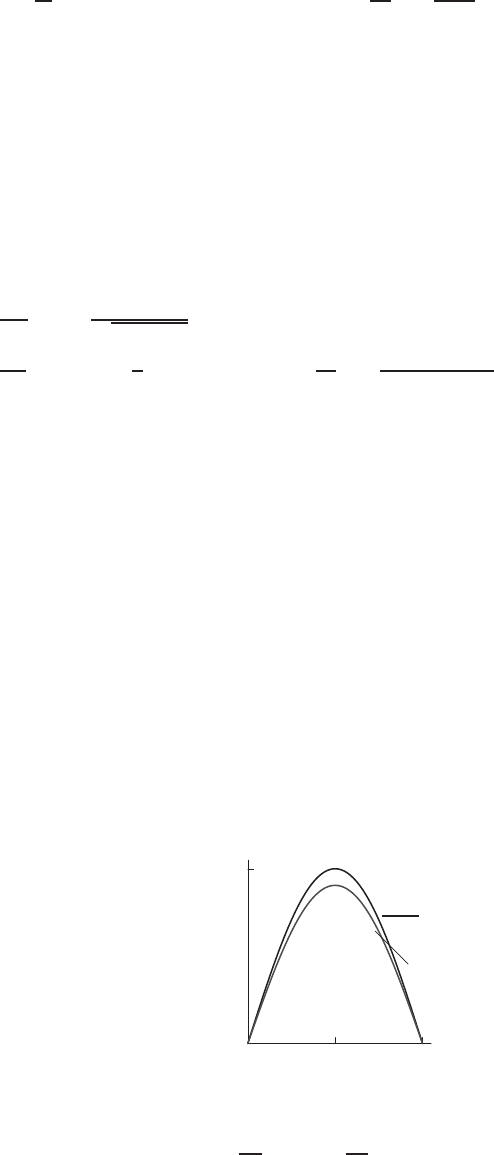
1278 Chapter Fourteen /SOLUTIONS
For constant m, the graph of gagainst rhas the shape shown in Figure 14.12, (the same shape as the graph of
y=1
x2). The slope of the graph in Figure 14.12 is ∂g
∂r =−2Gm
r3. So as rincreases, gdecreases, since the slope is
negative.
46. Substituting w= 65 and h= 160, we have
f(65,160) = 0.01(650.25 )(1600.75) = 1.277 m2.
This tells us that a person who weighs 65 kg and is 160 cm tall has a surface area of about 1.277 m2. Since
fw(w, h) = 0.01(0.25w−0.75 )h0.75 m2/kg,
we have fw(65,160) = 0.005 m2/kg. Thus, an increase of 1 kg in weight increases surface area by about 0.005 m2.
Since
fh(w, h) = 0.01w0.25 (0.75h−0.25 )m2/cm,
we have fh(65,160) = 0.006 m2/cm. Thus, an increase of 1 cm in height increases surface area by about 0.006 m2.
47. (a) ∂E
∂m =c2 1
p1−v2/c2−1!. We expect this to be positive because energy increases with mass.
(b) ∂E
∂v =mc2·−1
2(1 −v2/c2)−3/2−2v
c2=mv
(1 −v2/c2)3/2. We expect this to be positive because energy
increases with velocity.
48. The function in h(x, t)tells us the depth of the water in cm at position xmeters and time tseconds. Thus, hx(2,5) is in
cm per meter and ht(2,5) is in cm per second. So
hx(x, t) = −0.5 sin(0.5x−t)
hx(2,5) = −0.5 sin(0.5(2) −5) = −0.378 cm/meter.
ht(x, t) = sin(0.5x−t)
ht(2,5) = sin(0.5(2) −5) = 0.757 cm/second.
At position x= 2 and time t= 5, the value of hx(2,5) is the rate of change of depth of the water with distance—the
slope of the surface of the wave. The value of ht(2,5) is the vertical velocity of the surface of the water of the x= 2 at
time t= 5.
49. (a) Substituting t= 0 and t= 1 into the formula for Hgives:
H(x, 0) = 100 sin(πx)
H(x, 1) = 100e−0.1sin(πx) = 90.5 sin(πx).
The graphs of H(x, 0) and H(x, 1) are shown below.
10.5
✛H(x, 0) =
100 sin(πx)
■
H(x, 1) =
100e−0.1sin(πx)
= 90.5 sin(πx)
100
x
(meters)
temp
(◦C)
(b) To calculate Hx(x, t), we hold tconstant and differentiate with respect to x:
Hx(x, t) = ∂
∂x H(x, t) = ∂
∂x (100e−0.1tsin(πx)) = 100πe−0.1tcos(πx)
Hx(0.2, t) = 100πe−0.1tcos(0.2π) = 254.2e−0.1t◦C/meter
Hx(0.8, t) = 100πe−0.1tcos(0.8π) = −254.2e−0.1t◦C/meter.
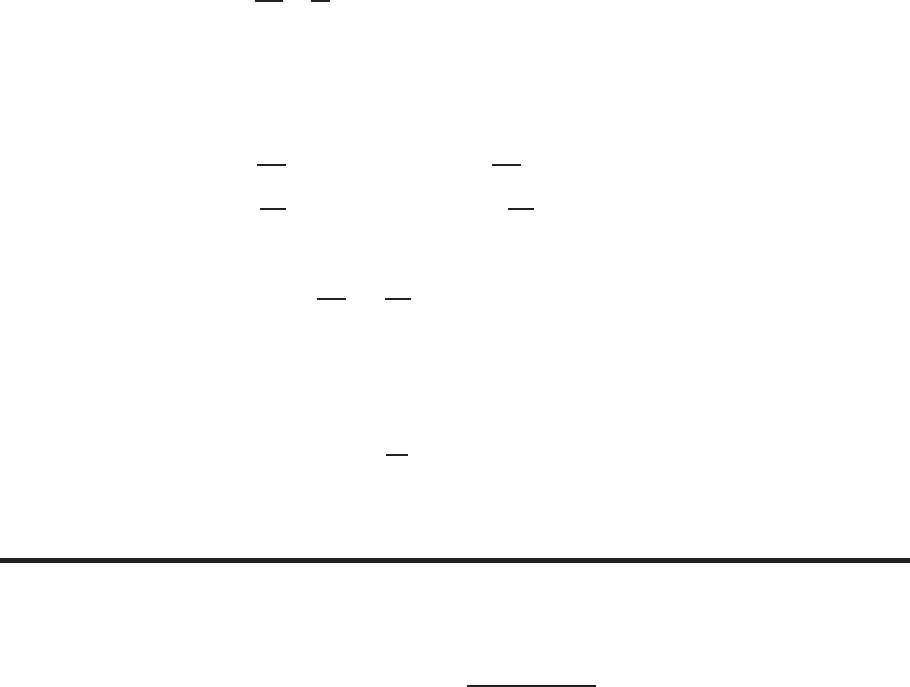
14.2 SOLUTIONS 1279
The practical interpretation of these partial derivatives is the rate of change in temperature at x= 0.2and x= 0.8as
we increase the distance from the end x= 0. Notice that e−0.1tis positive for all t. Given the formula for H(x, t),
we see that the closer the position to the center of the rod, the hotter the temperature. The partial derivative Hx(0.2, t)
has a positive sign because, at x= 0.2as we increase x, we get closer to the center of the rod which is hottest. The
partial derivative Hx(0.8, t)has a negative sign because, at x= 0.8as we increase x, we get further away from the
center of the rod which is hottest.
(c) To calculate Ht(x, t), we hold xconstant and differentiate with respect to t:
∂H
∂t =∂
∂t (100e−0.1tsin(πx)) = −10e−0.1tsin(πx)◦C/second.
For all t, and for 0< x < 1(that is, for all tand all xinside the rod), the partial derivative Ht(x, t)is negative. In
terms of heat, Ht(x, t)represents the rate at which the temperature of the rod is changing as time passes at position
xand time t. Thus, the temperature inside the rod is always decreasing.
50. We compute the partial derivatives:
∂Q
∂K =bαKα−1L1−αso K∂Q
∂K =bαKαL1−α
∂Q
∂L =b(1 −α)KαL−αso L∂Q
∂L =b(1 −α)KαL1−α
Adding these two results, we have:
K∂Q
∂K +L∂Q
∂L =b(α+ 1 −α)KαL1−α=Q.
51. Since fx(x, y) = 4x3y2−3y4, we could have
f(x, y) = x4y2−3xy4.
In that case,
fy(x, y) = ∂
∂y (x4y2−3xy4) = 2x4y−12xy3
as expected. More generally, we could have f(x, y) = x4y2−3xy4+C, where Cis any constant.
Strengthen Your Understanding
52. The variable with respect to which the partial derivative is taken needs to be specified. The function f(x, y) = x2y3has
two partial derivatives, fx= 2xy3and fy= 3y2x2.
53. The partial derivative fx(0,0) is defined as a limit of difference quotients:
fx(0,0) = lim
h→0
f(h, 0) −f(0,0)
h.
Evaluating a difference quotient for a specific value of h, such as h= 0.01, does not tell us the value or the sign of the
partial derivative.
For example, if f(x, y) = x2+y2, then f(0.01,0) −f(0,0) = 0.012>0, but fx(x, y) = 2x, so fx(0,0) = 0.
54. A linear function with the required partial derivatives is g(x, y) = 2x+ 3y. Adding to ga nonlinear function with both
partial derivatives equal to zero at the origin solves the problem. For example, f(x, y) = 2x+ 3y+x2has fx(0,0) = 2
and fy(0,0) = 3.
55. If f(x, y) = xy and g(x, y) = xy +y2, then
fx=gx=y
fy=x
gy=x+ 2y6=fy.
56. If f(x, y)is defined by a formula that does not contain x, then fx= 0 everywhere. For example, if f(x, y) = y2+ 1,
then fx= 0 and fis not constant.
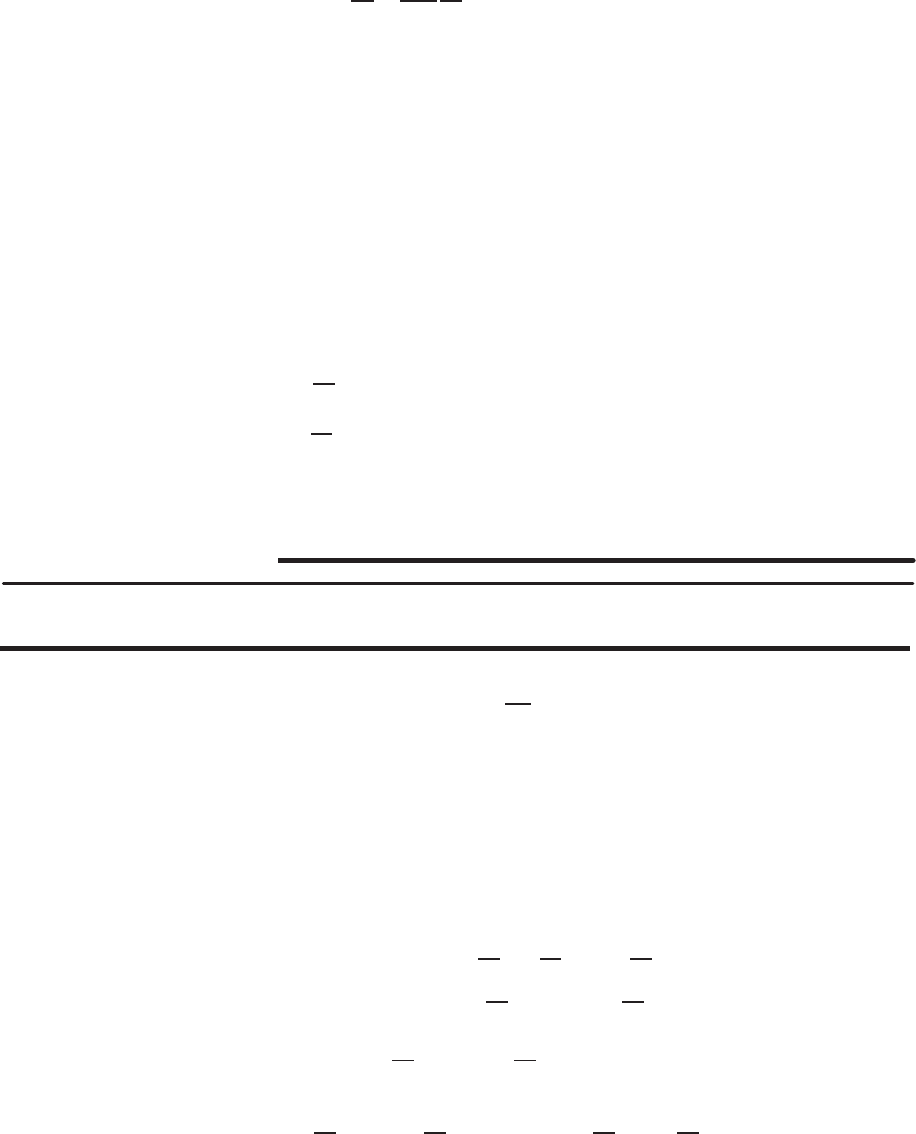
1280 Chapter Fourteen /SOLUTIONS
57. True. Any function of the form f(x, y) = xy +c, where cis a constant satisfies fx=yand fy=x.
58. True. Substituting ∂z/∂u = cos vand ∂z/∂v =−usin vinto the equation yields
cos v∂z
∂u −sin v
u
∂z
∂v = cos2v+ sin2v= 1.
59. True. Since gis a function of xonly, it can be treated like a constant when taking the ypartial derivative.
60. False. Differentiating with respect to sgives
ks=rses+res.
At the point (−1,2) we have ks(−1,2) = −3e2,which is negative, so kis decreasing in the s-direction.
61. False. In order to have fx(x, y) = y2, we would need fto have the form f(x, y) = xy2+h(y), where h(y)is a function
of yonly. Then the y-partial derivative of fwould be fy(x, y) = 2xy +h′(y), where h′(y)is the derivative of h(y). No
matter what function h(y)is, it will contain no x’s, so it is impossible for fyto equal x2.
62. False. The function fcould be any function of xonly. For example, f(x, y) = x2has fy(x, y) = 0.
63. False. Treating yconstant and taking the derivative with respect to xyields fx(x, y) = yeg(x)g′(x), using the chain rule.
64. False. For example, consider f(x, y) = xy. This function is symmetric, since f(y, x) = yx =xy =f(x, y), but
fx(x, y) = yand fy(x, y) = xare not equal.
65. Calculate the partial derivatives and check. The answer is (d), and
x∂
∂x (x0.4y0.6) = x0.4x−0.6y0.6= 0.4x0.4y0.6
y∂
∂y (x0.4y0.6) = yx0.40.6y−0.4= 0.6x0.4y0.6.
Thus
xfx+yfy= 0.4x0.4y0.6+ 0.6x0.4y0.6=x0.4y0.6=f.
Solutions for Section 14.3
Exercises
1. The partial derivatives are
zx=ex/y and zy=−x
yex/y +ex/y ,
so
zx(1,1) = eand zy(1,1) = −e1+e1= 0.
The tangent plane to z=yex/y at (x, y) = (1,1) has equation
z=z(1,1) + zx(1,1)(x−1) + zy(1,1)(y−1)
=e+e(x−1) + 0(y−1)
=ex.
2. Since
zx=ycos xy, we have zx2,3π
4=3π
4cos 2·3π
4= 0.
zy=xcos xy, we have zy2,3π
4= 2 cos 2·3π
4= 0.
Since
z2,3π
4= sin 2·3π
4=−1,
the tangent plane is
z=z2,3π
4+zx2,3π
4(x−2) + zy2,3π
4y−3π
4
z=−1.
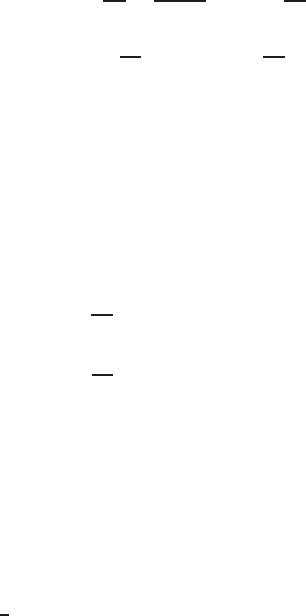
14.3 SOLUTIONS 1281
3. Differentiating gives
∂z
∂x =2x
x2+ 1 ,so ∂z
∂x (0,3,9)
= 0
∂z
∂y = 2y, so ∂z
∂y (0,3,9)
= 6.
Thus, the tangent plane is
z= 9 + 0(x−0) + 6(y−3)
z= 6y−9.
4. We have
z=ey+x+x2+ 6.
The partial derivatives are
∂z
∂x (x,y)=(1,0)
= (2x+ 1)(x,y)=(1,0)
= 3
∂z
∂y (x,y)=(1,0)
=ey(x,y)=(1,0)
= 1.
So the equation of the tangent plane is
z= 9 + 3(x−1) + y= 6 + 3x+y.
5. The partial derivatives are
zx=xand zy= 4y,
so
z(2,1) = 4, zx(2,1) = 2 and zy(2,1) = 4.
The tangent plane to z=1
2(x2+ 4y2)at (x, y) = (2,1) has equation
z=z(2,1) + zx(2,1)(x−2) + zy(2,1)(y−1)
= 4 + 2(x−2) + 4(y−1)
=−4 + 2x+ 4y.
6. The surface is given by
z=f(x, y) = x2+y2−1,
where f(1,3) = 9 and
fx= 2xand fy= 2y
and
fx(1,3) = 2 and fy(1,3) = 6.
Thus, the tangent plane is
z=f(1,3) + fx(1,3)(x−1) + fy(1,3)(y−3)
z= 9 + 2(x−1) + 6(y−3)
z= 2x+ 6y−11.
7. The surface is given by
z=f(x, y) = 40 −x2y2,
and f(2,3) = 40 −22·32= 4. We have
fx(x, y) = −2xy2,so fx(2,3) = −36.
and
fy(x, y) = −2x2y, so fy(2,3) = −24.
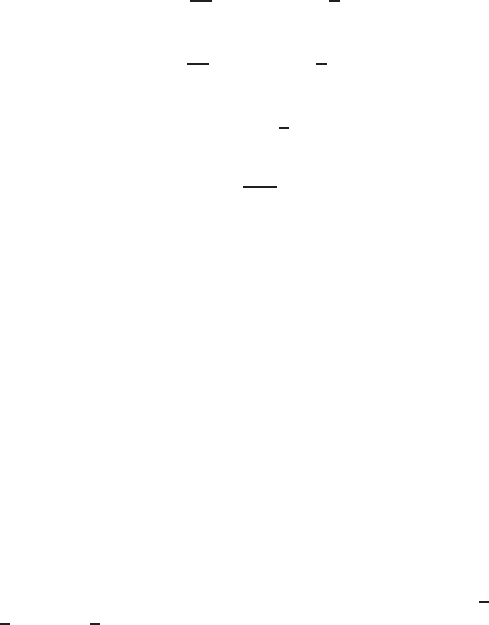
1282 Chapter Fourteen /SOLUTIONS
Thus, the tangent plane is
z=f(2,3) + fx(2,3)(x−2) + fy(2,3)(y−3)
z= 4 −36(x−2) −24(y−3)
z=−36x−24y+ 148.
8. The surface is given by
z=f(x, y) = 6 −x2y−ln(xy),
where f(4,0.25) = 2 and
fx=−2xy −1
xy ·y=−2xy −1
x
and
fy=−x2−1
xy ·x=−x2−1
y.
Thus
fx(4,0.25) = −2·4(0.25) −1
4=−2.25,
and
fy(4,0.25) = −42−1
0.25 =−20,
so the tangent plane is
z=f(4,0.25) + fx(4,0.25)(x−4) + fy(4,0.25)(y−0.25)
z= 2 −2.25(x−4) + 20(y−0.25)
z=−2.25x−20y+ 16.
9. df =ycos(xy)dx +xcos(xy)dy
10. Since gu= 2u+vand gv=u, we have
dg = (2u+v)du +u dv
11. Since zx=−e−xcos(y)and zy=−e−xsin(y), we have
dz =−e−xcos(y)dx −e−xsin(y)dy.
12. dh =e−3tcos(x+ 5t)dx + (−3e−3tsin(x+ 5t) + 5e−3tcos(x+ 5t)) dt
13. We have dg =gxdx +gtdt. Finding the partial derivatives, we have gx= 2xsin(2t)so gx(2,π
4) = 4 sin(π/2) = 4,
and gt= 2x2cos(2t)so gt(2,π
4) = 8 cos( π
2) = 0. Thus dg = 4 dx.
14. We have df =fxdx+fydy. Finding the partial derivatives, we have fx=e−yso fx(1,0) = e−0= 1, and fy=−xe−y
so fy(1,0) = −1e−0=−1. Thus, df =dx −dy.
15. We have dP =PLdL +PKdK.
Now
PK= (1.01)(0.75)K−0.25 L0.25
PK(100,1) ≈2.395,
and
PL= (1.01)(0.25)K0.75 L−0.75
PL(100,1) ≈0.008
Thus
dP ≈2.395 dK + 0.008 dL.
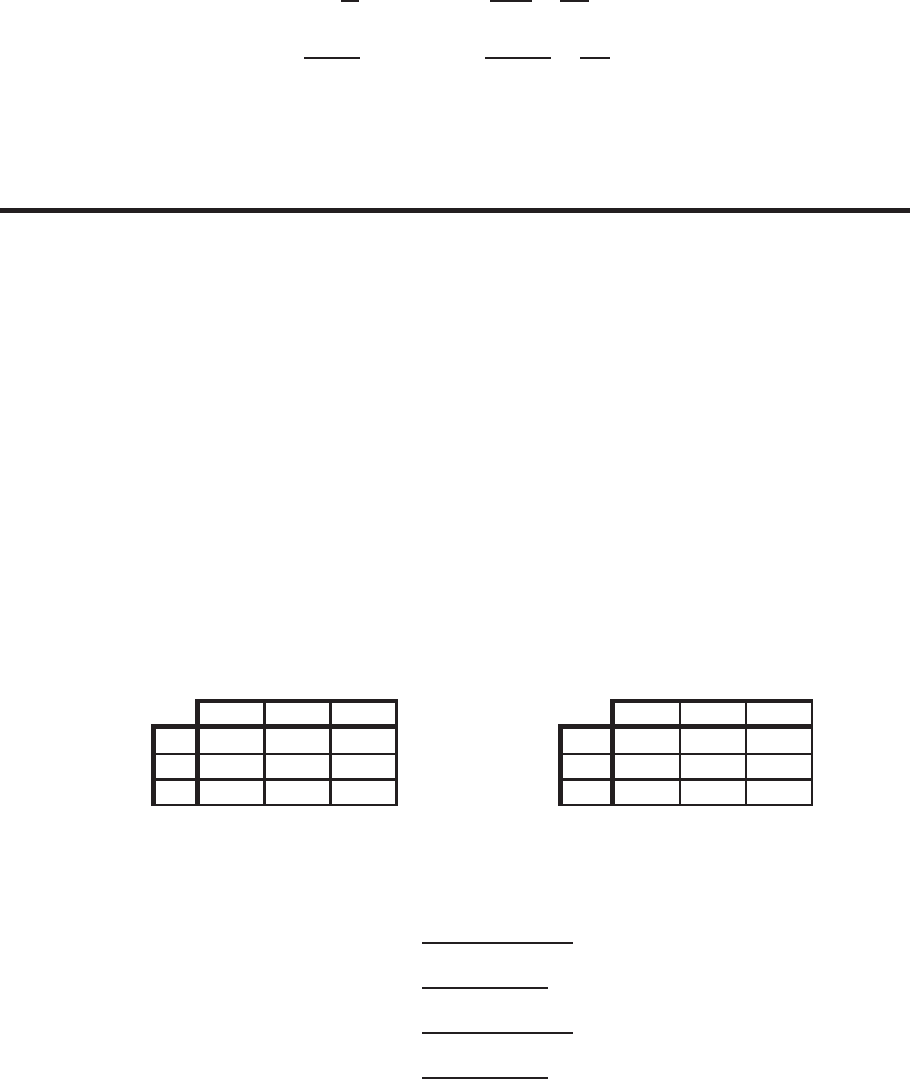
14.3 SOLUTIONS 1283
16. We have dF =Fmdm +Frdr.
Fm=G
r2, Fm(100,10) = G
(10)2=G
100 = 0.01G
Fr=−2Gm
r3, Fr(100,10) = −2G100
(10)3=−G
5=−0.2G.
Thus,
dF = 0.01G dm −0.2G dr.
Problems
17. (a) The units are dollars/square foot.
(b) The price of land 300 feet from the beach and of area near 1000 square feet is greater for larger plots by about $3 per
square foot.
(c) The units are dollars/foot.
(d) The price of a 1000 square foot plot about 300 feet from the beach is less for plots farther from the beach by about
$2 per extra foot from the beach.
(e) Compared to the 998 ft2plot at 295 ft from the beach, the other plot costs about 7×3 = $21 more for the extra
7 square feet but about 10 ×2 = $20 less for the extra 10 feet you have to walk to the beach. The net difference is
about a dollar, and the smaller plot nearer the beach is cheaper.
18. (a) Since the equation of a tangent plane should be linear, this answer is wrong.
(b) The student did not substitute the values x= 2,y= 3 into the formulas for the partial derivatives used in the formula
of a tangent plane.
(c) Let f(x, y) = z=x3−y2. Since fx(x, y) = 3x2and fy(x, y) = −2y, substituting x= 2,y= 3 gives
fx(2,3) = 12 and fy(2,3) = −6. Then the equation of the tangent plane is
z= 12(x−2) −6(y−3) −1,or z= 12x−6y−7.
19. (a) The two tables of values are Table 14.6 and 14.7.
Table 14.6
x
y
1.9 2.0 2.1
0.9 0.3847 0.3697 0.3510
1.0 0.3481 0.3345 0.3176
1.1 0.3150 0.3027 0.2873
Table 14.7
x
y
1.99 2.00 2.01
0.99 0.3394 0.3379 0.3363
1.00 0.3360 0.3345 0.3330
1.01 0.3327 0.3312 0.3297
Both tables are nearly linear. To check this, observe that the increments in each row (column) are equal, or nearly
so. Table 14.7 is more linear due to finer data.
(b) Table 14.7 shows f(1,2) ≈0.3345. Also
fx(1,2) ≈f(1.01,2) −f(1,2)
1.01 −1
=0.3312 −0.3345
0.01 =−0.3300,
fy(1,2) ≈f(1,2.01) −f(1,2)
2.01 −2
=0.3330 −0.3345
0.01 =−0.1500.
Using the estimates for the partial derivatives that we just made from the Table 14.7, we get that the local linearization
of faround (1,2) is
f(x, y)≈f(1,2) + fx(1,2)(x−1) + fy(1,2)(y−2)
= 0.3345 −0.33(x−1) −0.15(y−2).
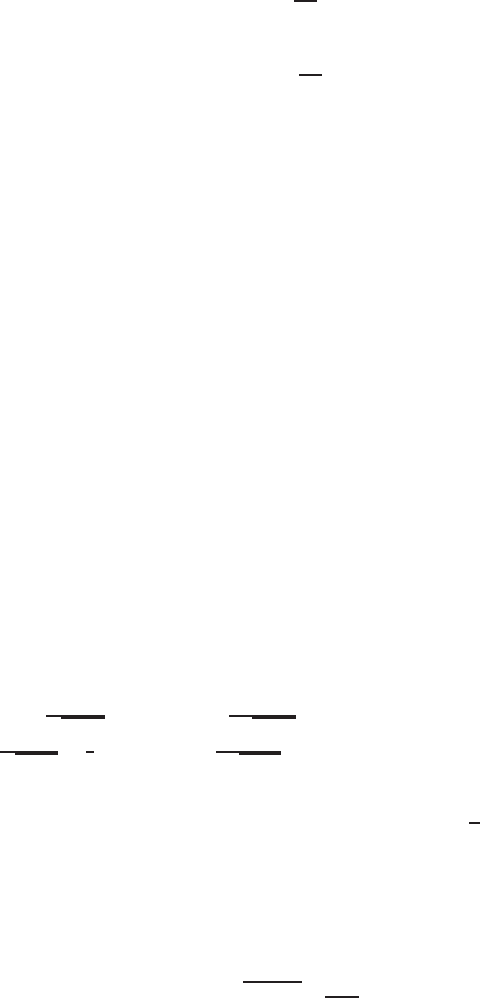
1284 Chapter Fourteen /SOLUTIONS
Now we use fx=−e−xsin(y)and fy=e−xcos(y), giving
fx(1,2) = −0.3345,
fy(1,2) = −0.1531.
These values of the partial derivatives tell us that the local linearization of faround (1,2) is
f(x, y)≈0.3345 −0.3345(x−1) −0.1531(y−2).
Notice that the two linearizations agree up to two decimal places.
20. We have
fx(3,1) = ∂f
∂x (3,1)
= 2xy|(3,1) = 6,
and
fy(3,1) = ∂f
∂y (3,1)
=x2|(3,1) = 9.
Also f(3,1) = 9.So the local linearization is,
z= 9 + 6(x−3) + 9(y−1).
21. The tangent plane approximation gives
∆h≈hx∆x+hy∆y,
or
h(x, y)≈h(a, b) + hx∆x+hy∆y.
With (a, b) = (600,100) and (x, y) = (605,98), we see that ∆x= 5 and and ∆x=−2. Thus
h(605,98) ≈300 + 12(5) −8(−2) = 376.
Using the information given, this is our best estimate for h(605,98). However, it may not be a good estimate if the
derivatives are changing rapidly near the point (600,100).
22. We need the partial derivatives, fx(1,0) and fy(1,0). We have
fx(x, y) = 2xexy +x2yexy ,so fx(1,0) = 2
fy(x, y) = x3exy ,so fy(1,0) = 1.
(a) Since f(1,0) = 1, the tangent plane is
z=f(1,0) + 2(x−1) + 1(y−0) = 1 + 2(x−1) + y.
(b) The linear approximation can be obtained from the equation of the tangent plane:
f(x, y)≈1 + 2(x−1) + y.
(c) At (1,0), the differential is
df =fxdx +fydy = 2dx +dy.
23. Since fx(x, y) = x
√x2+y3and fy(x, y) = 3y2
2√x2+y3,
fx(1,2) = 1
√12+23=1
3and fy(1,2) = 3·22
2√12+23= 2.
Thus the differential at the point (1,2) is
df =df(1,2) = fx(1,2)dx +fy(1,2)dy =1
3dx + 2dy.
Using the differential at the point (1,2), we can estimate f(1.04,1.98). Since
△f≈fx(1,2)△x+fy(1,2)△y
where △f=f(1.04,1.98) −f(1,2) and △x= 1.04 −1and △y= 1.98 −2, we have
f(1.04,1.98) ≈f(1,2) + fx(1,2)(1.04 −1) + fy(1,2)(1.98 −2)
=p12+ 23+0.04
3−2(0.02) ≈2.973.

14.3 SOLUTIONS 1285
24. (a) Calculating partial derivatives, we obtain gu(u, v) = 2u+vand gv(u, v) = u. Therefore, dg =gu(u, v)du +
gv(u, v)dv = (2u+v)du +u dv, and so our final answer is dg = (2u+v)du +u dv.
(b) Let (u, v) = (1,2).In moving from (1,2) to (1.2,2.1),we see that ∆u=du = 0.2and ∆v=dv = 0.1.
Therefore, we have
dg = (2(1) + 2)(0.2) + (1)(0.1)
= 0.8 + 0.1
= 0.9,
which is our final answer.
25. Local linearization gives us the approximation
T(x, y)≈T(2,1) + Tx(2,1)(x−2) + Ty(2,1)(y−1)
T(x, y)≈135 + 16(x−2) −15(y−1).
Thus,
T(2.04,0.97) ≈135 + 16(2.04 −2) −15(0.97 −1) = 136.09◦C.
26. We first recall that the formula for a volume of a right circular cylinder is V=πr2h, where ris the radius of the cylinder
and his the height of the cylinder. In our case, we are being asked to calculate dV, the approximate change in V, when r
changes from 50 to 51 cm and hchanges from 100 to 101 cm. We have
dV =Vr(r, h)dr +Vh(r, h)dh
= 2πrh dr +πr2dh
= 2π(50)(100) ·1 + π(50)2·1
= 10000π+ 2500π,
so we conclude that the volume changes by approximately 12500πor 39270 cm3.
27. Making use of the values of Prand PLfrom the solution to Problem 27 on page 1270, we have the local linearizations:
For (r, L) = (8,4000),
P(r, L)≈80 + 2.5(r−8) + 0.02(L−4000),
For (r, L) = (8,6000),
P(r, L)≈120 + 3.33(r−8) + 0.02(L−6000),
For (r, L) = (13,7000),
P(r, L)≈160 + 3.33(r−13) + 0.02(L−7000).
28. A linear approximation near (480,20) is given by
f(T, P )≈f(480,20) + fT(480,20)(T−480) + fP(480,20)(P−20).
Directly from the table on page 774, we have
fT(480,20) ≈f(480,20) −f(500,20)
−20 =27.85 −28.46
−20 = 0.0305
fp(480,20) ≈f(480,20) −f(480,22)
−2=27.85 −25.31
−2=−1.27
This yields the linear approximation near (480,20)
f(T, P )≈27.85 + 0.0305(T−480) −1.27(P−20)
= 0.0305T−1.27P+ 38.61.

1286 Chapter Fourteen /SOLUTIONS
29. (a) The linear approximation gives
f(520,24) ≈24.20, f(480,24) ≈23.18,
f(500,22) ≈25.52, f(500,26) ≈21.86.
The approximations for f(520,24) and f(500,26) agree exactly with the values in the table; the other two do not.
The reason for this is that the partial derivatives were estimated using difference quotients with these values.
(b) We could get a more balanced estimate by using a difference quotient that uses the values on both sides. Thus, we
could estimate the partial derivatives as follows:
fT(500,24) ≈f(520,24) −f(480,24)
40
=(24.20 −23.19)
40 = 0.02525,
and
fp(500,24) ≈f(500,26) −f(500,22)
4
=(21.86 −25.86)
4=−1.
This yields the linear approximation
V=f(T, p)≈23.69 + 0.02525(T−500) −(p−24) ft3.
This approximation yields values
f(520,24) ≈24.195, f(480,24) ≈23.185,
f(500,22) ≈25.69, f(500,26) ≈21.69.
Although none of these predictions are accurate, the error in the predictions that were wrong before has been reduced.
This new linearization is a better all-round approximation for values near (500,24).
30. Letting ∆Tdenote the change in temperature between these two points, we have
∆T≈fx(3,5)∆x+ft(3,5)∆t
=−2◦C
m(−0.5m) + 1.2◦C
min (1 min)
= 1◦C+ 1.2◦C
= 2.2◦C.
We therefore see that the temperature would be about 2.2◦C warmer at our destination.
31. (a) Solving for Pgives
P=f(T, V ) = nRT
V−nb −n2a
V2.
(b) Since
∂P
∂T =fT(T, V ) = nR
V−nb
∂P
∂V =fV(T, V ) = −nRT
(V−nb)2+2n2a
V3,
we have
∆P≈fT(T0, V0)∆T+fV(T0, V0)∆V
∆P≈nR
V0−nb ∆T+−nRT0
(V0−nb)2+2n2a
V3
0∆V.
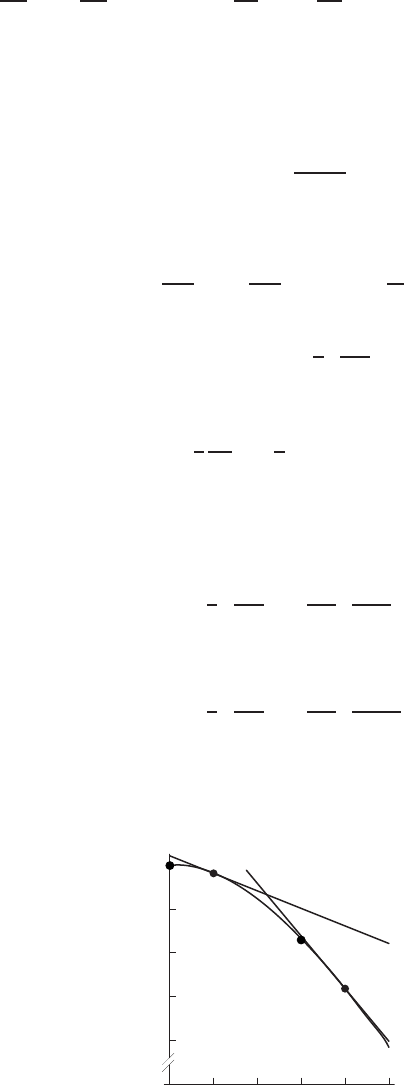
14.3 SOLUTIONS 1287
32. (a) When V= 25 and P= 1, we have T= 304.9. The differential dT is
dT =∂T
∂V dV +∂T
∂P dP = (−16.574 1
V2+ 1.06 1
V3+ 12.187P)dV + (−0.3879 + 12.187V)dP.
When V= 25 and P= 1 this is
dT = 12.16 dV + 304.29 dP.
(b) If ∆P= 0.1and ∆T= 0, then
0≈(12.16)∆V+ (304.29)(0.1),
so
∆V≈ −30.429
12.16 ≈ −2.5.
Thus the volume would have to decrease by about 2.5 dm3, or about 10%.
33. (a) For a mass mof liquid, we have ρ=m/V , so
dρ =−m
V2dV =−m
V2βV dT =−βm
VdT =−βρ dT.
(b) From part (a), we have ∆ρ≈ −βρ∆T, so
β≈ −1
ρ·∆ρ
∆T.
Thus, in the limit as ∆Tand ∆ρbecome very small, we have
β=−1
ρ
dρ
dT =−1
ρ Slope of tangent line
in Figure 14.13 !.
We use Figure 14.13 to estimate ρ,∆ρ, and ∆T. We use these values to approximate β.
From Figure 14.13 we see that ρ≈997 when T= 20. In addition, we see that ρ≈1000 when T= 0. Between
these points, the temperature change is ∆T= 20 −0 = 20, and the density change is ∆ρ= 997 −1000 = −3.
Thus, ∆ρ≈ −βρ∆T
β≈ −1
ρ·∆ρ
∆T=−1
997 ·(−3)
20 ≈0.00015.
At T= 80 we have ρ≈973 and at T= 60, we have ρ≈983. Thus ∆T= 80 −60 = 20, and ∆ρ=
973 −983 = −10, so when T= 80 we have,
β≈ −1
ρ·∆ρ
∆T=−1
973 ·(−10)
20 ≈0.0005.
As you can see from Figure 14.13, using ∆T= 20 may not give a very good approximation. To get a better
approximation, use a smaller value of ∆T.
ρ(
kg
/
m
3)
T(◦
C
)
0 20 40 60 80 100
960
970
980
990
1000
(60,983)
(80,973)
(20,997)
Figure 14.13
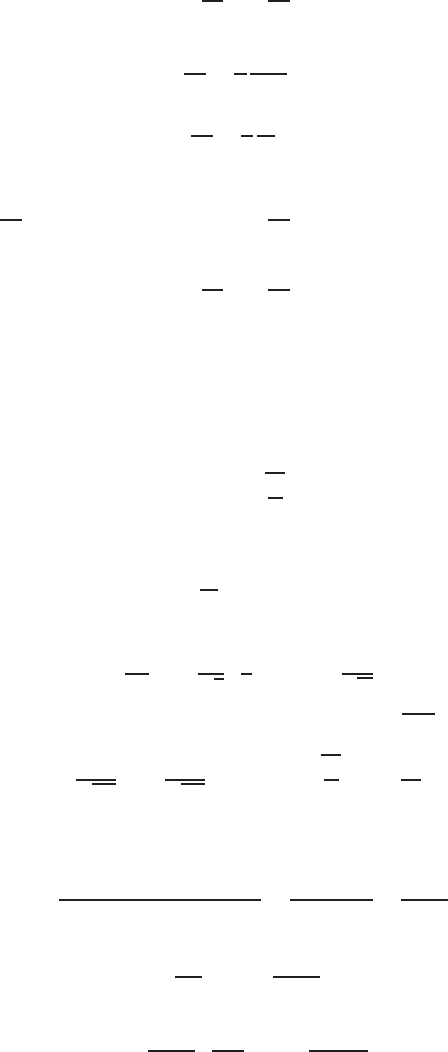
1288 Chapter Fourteen /SOLUTIONS
34. The error in ηis approximated by dη, where
dη =∂η
∂r dr +∂η
∂p dp.
We need to find
∂η
∂r =π
8
p4r3
v
and
∂η
∂p =π
8
r4
v.
For r= 0.005 and p= 105we get
∂η
∂r (0.005,105) = 3.14159 ·107,∂η
∂p (0.005,105) = 0.39270,
so that
dη =∂η
∂r dr +∂η
∂p dp.
is largest when we take all positive values to give
dη = 3.14159 ·107·0.00025 + 0.39270 ·1000 = 8246.68.
This seems quite large but η(0.005,105) = 39269.9so the maximum error represents about 20% of any value
computed by the given formula. Notice also the relative error in ris ±5%, which means the relative error in r4is ±20%.
35. At temperature t0, the length is l0and the period is
T0= 2πrl0
g.
Now suppose the temperature changes by ∆t, causing a change in length, ∆l. Since l=l0(1 + α(t−t0)), we have
∆l≈dl
dt ∆t=l0α∆t.
The change in period, ∆T, caused by this change in length is given by
∆T≈dT
dl ∆l=2π
√g·1
2l−1/2∆l=π
√gl ∆l.
At t=t0, we have l=l0, so substituting for ∆land using the fact that T0= 2πpl0/g, we have
∆T≈π
√gl0
∆l=π
√gl0
l0α∆t=παrl0
g∆t=αT0
2∆t.
Now we have to figure out how many seconds a day the clock gains or loses as a result of this change in period. We
assume the units of land gare chosen to given Tin seconds. When the period is T, the pendulum executes Noscillations
per day, where
N=Number of seconds in a day
Period in seconds =24 ·60 ·60
T=86400
T.
Thus, when the period changes from T0to T0+ ∆T, we have
∆N≈dN
dT ∆T=−86400
T2
0
∆T.
Substituting for ∆Tgives
∆N≈ −86400
T2
0·αT0
2∆t=−43200α
T0
∆t.
The clock records T0seconds as having passed for each oscillation executed. Therefore the number of seconds gained or
lost per day when Nchanges by ∆Nis given by
Number of seconds gained/lost per day =T0∆N=−43200∆t.
The number of seconds is negative and the clock is slow if ∆t > 0; the number of seconds is positive and the clock is fast
if ∆t < 0. The answer −43200∆tis independent of l0.

14.3 SOLUTIONS 1289
36. (a) The local linearization of f(x, y)at (a, b)is
g(x, y) = f(a, b) + fx(a, b)(x−a) + fy(a, b)(y−b).
The contour of gthrough (a, b)is g(a, b) = c, where
c=f(a, b) + fx(a, b)(a−a) + fy(a, b)(b−b) = f(a, b).
Thus, the contour of gthrough (a, b)is
f(a, b) = f(a, b) + fx(a, b)(x−a) + fy(a, b)(y−b)
0 = fx(a, b)(x−a) + fy(a, b)(y−b).
Since the local linearization g(x, y)gives the best linear approximation to fat (a, b), the contour of gthrough (a, b)
must be the tangent line to the contour of fthrough (a, b). Thus, the tangent line is
fx(a, b)(x−a) + fy(a, b)(y−b) = 0.
(b) Putting the equation in part (a) in slope-intercept form we have
y=−fx(a, b)
fy(a, b)x+afx(a, b)
fy(a, b)+b.
The slope is the coefficient of x, which is −fx(a, b)/fy(a, b).
(c) We have fx(3,4) = 10 and fy(3,4) = 3. The tangent line has the equation 10(x−3) + 3(y−4) = 0.
Strengthen Your Understanding
37. A correct equation for the tangent plane at the point (3,4) is
z=f(3,4) + fx(3,4)(x−3) + fy(3,4)(y−4).
38. The equations of the tangent planes are
z=f(0,0) + fx(0,0)x+fy(0,0)y
z=g(0,0) + gx(0,0)x+gy(0,0)y.
If the function values at the origin are not equal, f(0,0) 6=g(0,0), then the two planes are parallel but not identical. For
example, if f(x, y) = x2+y2and g(x, y) = x2+y2+ 2, then the tangent planes to the graphs of these functions at the
origin are z= 0 and z= 2, respectively.
39. The given equation is not linear, so it is not the equation of a plane.
Let f(x, y) = x2y. The tangent plane to the surface z=f(x, y)at the point (1,2) has equation
z=f(1,2) + fx(1,2)(x−1) + fy(1,2)(y−2).
The derivatives fx(x, y) = 2xy and fy(x, y) = x2must be evaluated at the point (1,2). The correct tangent plane
equation is
z= 2 + 4(x−1) + (y−2).
40. For any function f(x, y)and any constant C, the two functions f(x, y)and g(x, y) = f(x, y) + Chave the same
differential. For example, f(x, y) = xy2and g(x, y) = xy2+ 10 have the same differential:
df =y2dx + 2xy dy
and
dg =y2dx + 2xy dy.
41. The plane z= 3 is a horizontal plane parallel to the xy-plane. This plane is tangent to the sphere of radius 3 centered at
the origin. Other examples are possible, the graph of the paraboloid z= 3 −x2−y2also has tangent plane z= 3 at
(0,0,3).
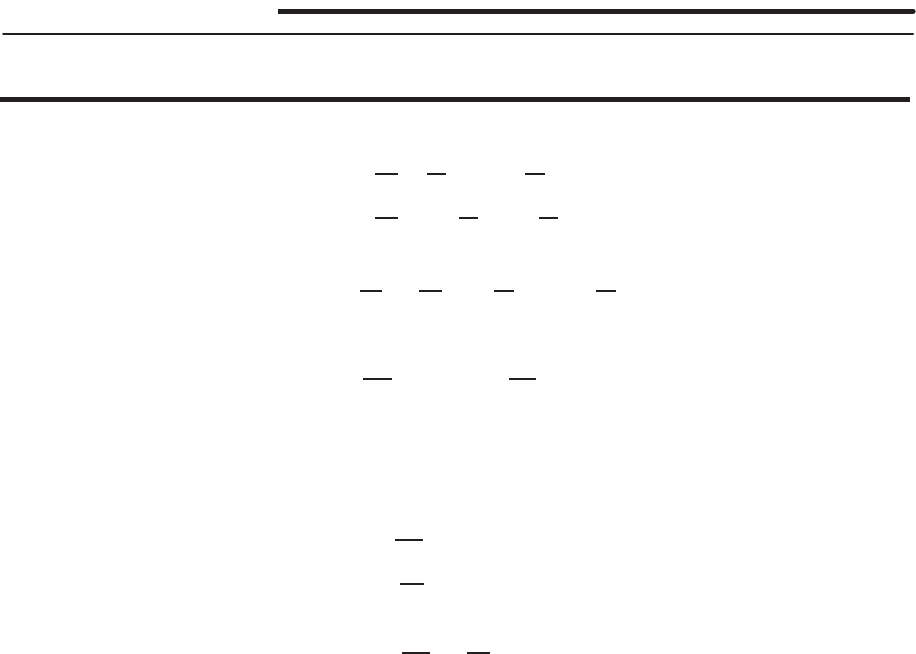
1290 Chapter Fourteen /SOLUTIONS
42. True. The partials are fx= 2xyex2and fy=ex2, so fx(0,1) = 0 and fy(0,1) = 1. Then the tangent plane has equation
z=f(0,1) + 0(x−0) + 1(y−1) = 1 + y−1 = y.
43. True. The change in fis approximately df = 2 ·2·(−0.1) + sin(2) ·0.0002.Since −1≤sin x≤1, the term
sin(2) ·0.0002 is small in comparison to the first term, which is −0.4.
In fact, df = 2 ·2(−0.1) + sin(2) ·0.0002 ≈ −0.3998.
44. False. The graph of fis a paraboloid, opening upward. The tangent plane to this surface at any point lies completely under
the surface (except at the point of tangency). So the local linearization underestimates the value of fat nearby points.
45. False. As a counterexample, consider f(x, y) = x2+y2and g(x, y) = 2x+y2at the point (1,1).Then both functions
have differential 2dx + 2 dy at the point (1,1).
46. False. As a counterexample, consider f(x, y) = x2+y2and g(x, y) = 2x+y2−1at the point (1,1).Then both
functions have tangent plane z= 2 + 2(x−1) + 2(y−1) at the point (1,1).
47. True. If fis a constant function, there is no change in fbetween any two points. Alternatively, fx=fy= 0,so
df = 0 dx + 0 dy = 0.
48. True. If fis linear, then f(x, y) = mx +ny +cfor some m, n and c. So fx=mand fy=ngiving df =m dx +n dy,
which is linear in the variables dx and dy.
49. False. The property of local linearity is that most functions behave approximately linearly close to a point. While the
contours may appear parallel and equally spaced, unless the function is already linear they won’t be exactly parallel or
evenly spaced, no matter how closely we zoom.
Solutions for Section 14.4
Exercises
1. Since the partial derivatives are
∂f
∂x =15
2x4−0 = 15
2x4
∂f
∂y = 0 −24
7y5=−24
7y5
we have
grad f=∂f
∂x~
i+∂f
∂y~
j=15
2x4~
i−24
7y5~
j .
2. Since the partial derivatives are
∂Q
∂K = 50 and ∂Q
∂L = 100
we have
∇f= 50
~
i+ 100~
j .
3. Since the partial derivatives are
∂f
∂m = 2m+ 0 = 2m
∂f
∂n = 0 + 2n= 2n
we have
grad f=∂f
∂m~
i+∂f
∂n~
j= 2m
~
i+ 2n~
j .
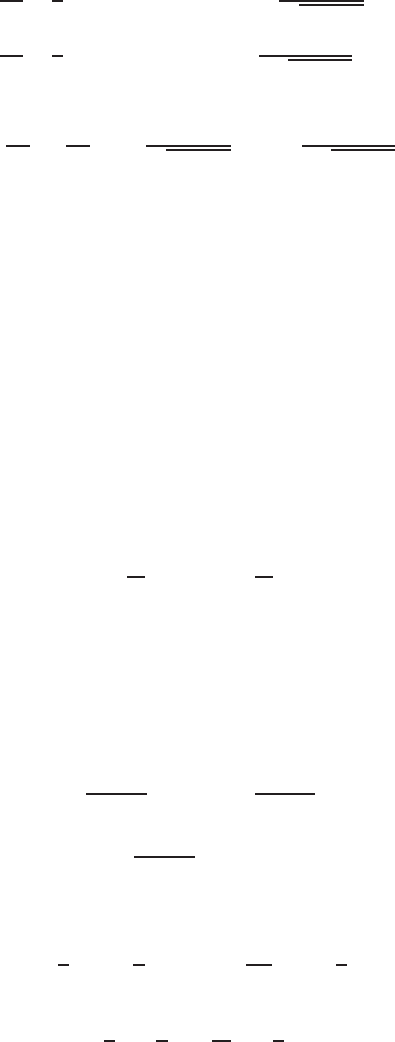
14.4 SOLUTIONS 1291
4. Since the partial derivatives are
zx=eyand zy=xey
we have
∇z=ey
~
i+xey~
j .
5. Since the partial derivatives are
∂f
∂α =1
2(5α2+β)−1/2(10α+ 0) = 5α
p5α2+β
∂f
∂β =1
2(5α2+β)−1/2(0 + 1) = 1
2p5α2+β,
we have
grad f=∂f
∂α~
i+∂f
∂β~
j= 5α
p5α2+β!~
i+ 1
2p5α2+β!~
j.
6. Since the partial derivatives are
fr= 2πrh and fh=πr2,
we have
∇f= 2πrh
~
i+πr2~
j .
7. Since the partial derivatives are
zx=eyand zy=xey+ey+yey,
we have
∇z=ey
~
i+ey(1 + x+y)~
j .
8. Since the partial derivatives are
fK= 0.3K−0.7L0.7and fL= 0.7K0.3L−0.3,
we have
∇f= 0.3L
K0.7~
i+ 0.7K
L0.3~
j .
9. Since the partial derivatives are
fr= sin θand fθ=rcos θ,
we have
∇f= sin θ
~
i+rcos θ~
j .
10. Since the partial derivatives are
fx=2x
x2+y2and fy=2y
x2+y2,
we have
∇f=2
x2+y2(x
~
i+y~
j).
11. Since the partial derivatives are
zx=1
ycos x
y, zy=−x
y2cos x
y
we have
∇z=1
ycos ( x
y)
~
i−x
y2cos ( x
y)~
j .
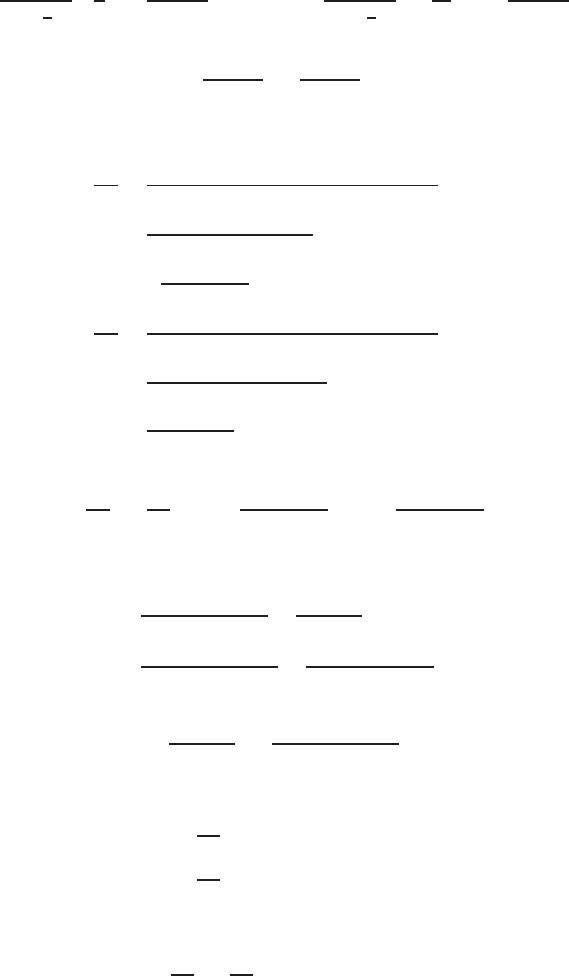
1292 Chapter Fourteen /SOLUTIONS
12. Since the partial derivatives are
zx=1
1 + x
y21
y=y
y2+x2,and zy=1
1 + x
y2−x
y2=−x
y2+x2,
we have
∇z=y
y2+x2~
i−x
y2+x2~
j .
13. Since the partial derivatives are
∂f
∂α =(2α−3β)(2 + 0) −(2 −0)(2α+ 3β)
(2α−3β)2
=4α−6β−(4α+ 6β)
(2α−3β)2
=−12β
(2α−3β)2
∂f
∂β =(2α−3β)(0 + 3) −(0 −3)(2α+ 3β)
(2α−3β)2
=(6α−9β) + (6α+ 9β)
(2α−3β)2
=12α
(2α−3β)2
we have
grad f=∂f
∂α~
i+∂f
∂β~
j=−12β
(2α−3β)2~
i+12α
(2α−3β)2~
j .
14. Since the partial derivatives are
zx=ey(x+y)−xey
(x+y)2=yey
(x+y)2
zy=xey(x+y)−xey
(x+y)2=ey(x2+xy −x)
(x+y)2
we have
∇z=yey
(x+y)2~
i+ey(x2+xy −x)
(x+y)2~
j
15. Since the partial derivatives are
∂f
∂x = 2xy + 7y3
∂f
∂y =x2+ 21xy2
we have
grad f(1,2)
=∂f
∂x~
i+∂f
∂y~
j(1,2)
=(2xy + 7y3)
~
i+ (x2+ 21xy2)~
j(1,2)
=2(1)(2) + 7(2)3~
i+(1)2+ 21(1)(2)2~
j
= (4 + 56)
~
i+ (1 + 84)~
j
= 60
~
i+ 85~
j
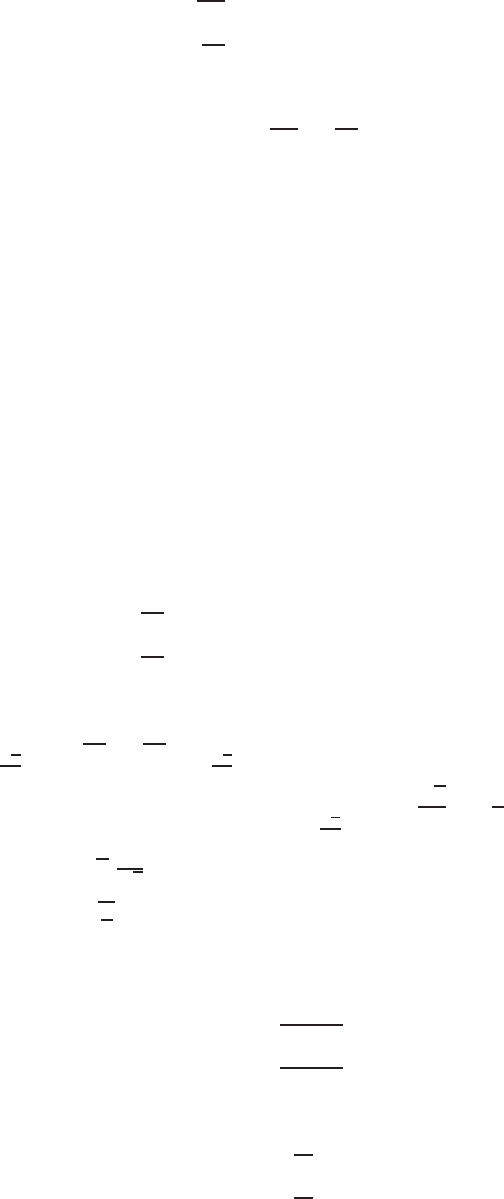
14.4 SOLUTIONS 1293
16. Since the partial derivatives are
∂f
∂m = 10m+ 0 = 10m
∂f
∂n = 0 + 12n3= 12n3
we have
grad f(5,2)
=∂f
∂m~
i+∂f
∂n~
j(5,2)
= 10m
~
i+ 12n3~
j(5,2)
= 10(5)
~
i+ 12(2)3~
j
= 50
~
i+ 96~
j
17. Since the partial derivatives are
fr= 2π(h+r)and fh= 2πr,
we have
∇f(2,3) = 10π~
i+ 4π~
j .
18. The gradient of esin yat x= 0,y=πis given by
grad(esin y)(0,π)
= 0
~
i+ (cos yesin y)~
j(0,π)
= (−1)e0~
j=−~
j .
19. Since the partial derivatives are
∂f
∂x = cos (x2)·(2x) + 0 = 2xcos (x2)
∂f
∂y = 0 −sin y=−sin y
we have
grad f(√π
2,0)
=∂f
∂x~
i+∂f
∂y~
j(√π
2,0)
=2xcos(x2)~
i+ (−sin y)~
j(√π
2,0)
=2( √π
2) cos( π
4)~
i+ (−sin 0)~
j
=√π(1
√2)~
i+ 0
=qπ
2~
i
20. Since the partial derivatives are
fx=2x+y
x2+xy
fy=x
x2+xy
at the point (4,1), we have
fx(4,1) = 9
20 = 0.45
fy(4,1) = 4
20 = 0.2.
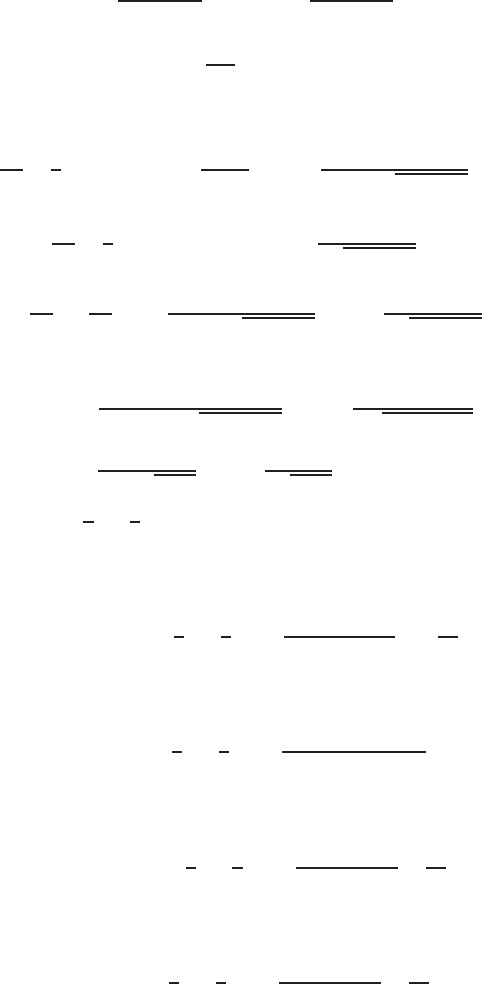
1294 Chapter Fourteen /SOLUTIONS
Then
gradf(4,1) = 0.45
~
i+ 0.2~
j .
21. Since the partial derivatives are
fx=−2x
(x2+y2)2and fy=−2y
(x2+y2)2,
we have
∇f=1
100 (2
~
i−6~
j).
22. Since the partial derivatives are
∂f
∂x =1
2(tan x+y)−1/21
cos2x+ 0=1
2 cos2x√tan x+y,
and ∂f
∂y =1
2(tan x+y)−1/2(0 + 1) = 1
2√tan x+y,
then
grad f=∂f
∂x~
i+∂f
∂y~
j=1
2 cos2x√tan x+y~
i+1
2√tan x+y~
j .
Hence we have
grad f(0,1)
= 1
2(cos(0))2ptan(0) + 1 !~
i+ 1
2ptan(0) + 1) !~
j
=1
2(1)2√0 + 1 ~
i+1
2√0 + 1 ~
j
=1
2~
i+1
2~
j
23. Since fx=yand fy=x+ 3y2, at (1,2) we have grad f= 2
~
i+ 13~
j . Thus
f~u (1,2) = grad f·3
5~
i−4
5~
j=2·3 + 13(−4)
5=−46
5.
24. Since fx= 3 and fy=−4, we have grad f= 3
~
i−4~
j . Thus
f~u (1,2) = grad f·3
5~
i−4
5~
j=3·3+ (−4) ·(−4)
5= 5.
25. Since fx= 2xand fy=−2y, at (1,2) we have grad f= 2
~
i−4~
j . Thus
f~u (1,2) = grad f·3
5~
i−4
5~
j=2·3−4(−4)
5=22
5.
26. Since fx= 2 cos(2x−y)and fy=−cos(2x−y), at (1,2) we have grad f= 2 cos(0)
~
i−cos(0)~
j= 2
~
i−~
j . Thus
f~u (1,2) = grad f·3
5~
i−4
5~
j=2·3−1(−4)
5=10
5= 2.

14.4 SOLUTIONS 1295
27. Since k~v k= 5, we see that ~v is not a unit vector. The unit vector ~u in the direction of ~v is
~u =~v
k~v k=4
5~
i−3
5~
j .
The partial derivatives are fx(x, y) = 2xy and fy(x, y) = x2. So
f~u (2,6) = fx(2,6) ·4
5+fy(2,6) ·−3
5= 24 4
5+ 4 −3
5=84
5.
28. Since grad f=fx
~
i+fy~
jand df =fxdx +fydy we have
df =ydx +xdy.
29. Since grad f=fx
~
i+fy~
jand df =fxdx +fydy we have
df = (2x+ 3ey)dx + 3xeydy.
30. Since df =fxdx +fydy and grad f=fx
~
i+fy~
jwe have
grad f= 2x
~
i+ 10y~
j .
31. Since df =fxdx +fydy and grad f=fx
~
i+fy~
jwe have
grad f= (x+ 1)yex
~
i+xex~
j .
32. Since the values of zdecrease as we move in direction~
ifrom the point (−2,2), the directional derivative is negative.
33. Since the values of zdecrease as we move in direction ~
jfrom the point (0,−2), the directional derivative is negative.
34. Since the values of zdecrease as we move in direction~
i+2~
jfrom the point (0,−2), the directional derivative is negative.
35. Since the values of zincrease as we move in direction~
i−2~
jfrom the point (0,−2), the directional derivative is positive.
36. Since the values of zstay approximately the same (since the direction is tangent to the contour) as we move in direction
~
i+~
jfrom the point (−1,1), the directional derivative is approximately zero.
37. Since the values of zincrease as we move in direction −~
i+~
jfrom the point (−1,1), the directional derivative is positive.
38. The approximate direction of the gradient vector at point (−2,0) is −~
i, since the gradient vector is perpendicular to the
contour and points in the direction of increasing z-values. Answers may vary since answers are approximate and any
positive multiple of the vector given is also correct.
39. The approximate direction of the gradient vector at point (0,−2) is −~
j, since the gradient vector is perpendicular to
the contour and points in the direction of increasing z-values. Answers may vary since answers are approximate and any
positive multiple of the vector given is also correct.
40. The approximate direction of the gradient vector at point (2,0) is ~
i, since the gradient vector is perpendicular to the
contour and points in the direction of increasing z-values. Answers may vary since answers are approximate and any
positive multiple of the vector given is also correct.
41. The approximate direction of the gradient vector at point (0,2) is ~
j, since the gradient vector is perpendicular to the
contour and points in the direction of increasing z-values. Answers may vary since answers are approximate and any
positive multiple of the vector given is also correct.
42. The approximate direction of the gradient vector at point (−2,2) is −~
i+~
j, since the gradient vector is perpendicular to
the contour and points in the direction of increasing z-values. Answers may vary since answers are approximate and any
positive multiple of the vector given is also correct.
43. The approximate direction of the gradient vector at point (−2,−2) is −~
i−~
j, since the gradient vector is perpendicular
to the contour and points in the direction of increasing z-values. Answers may vary since answers are approximate and
any positive multiple of the vector given is also correct.
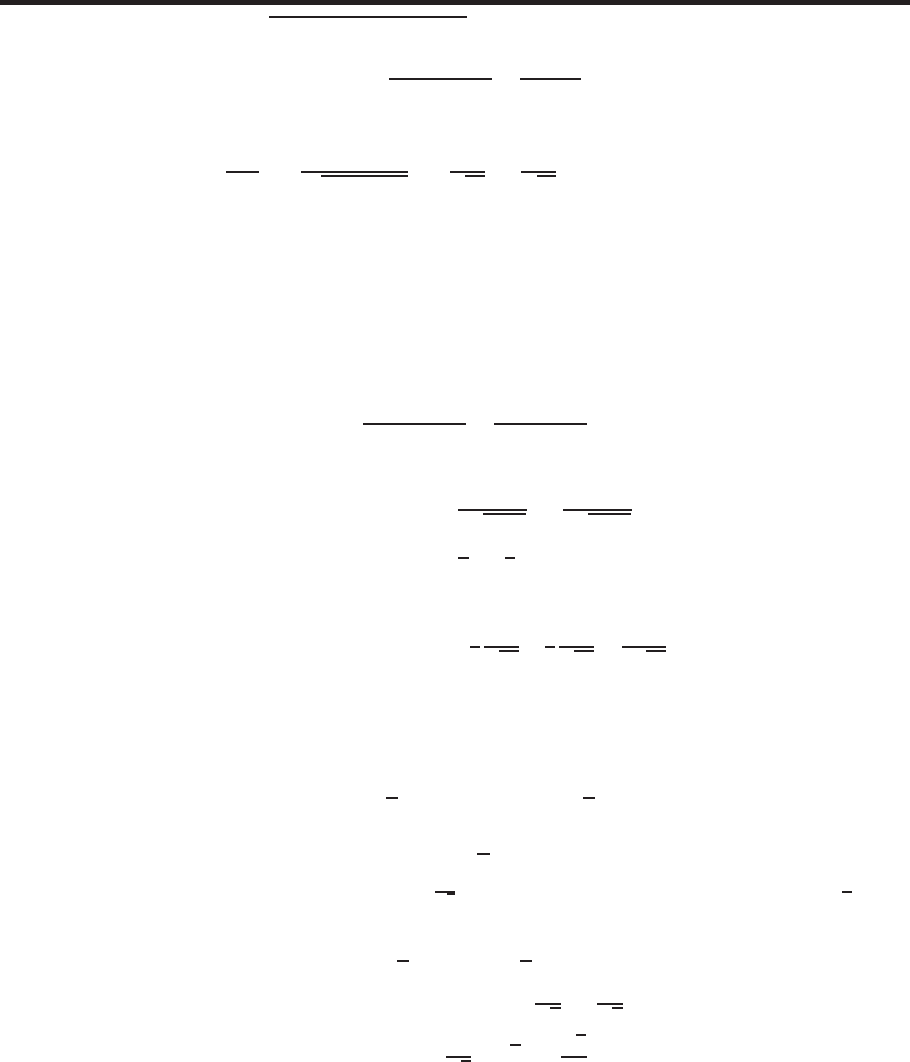
1296 Chapter Fourteen /SOLUTIONS
44. The approximate direction of the gradient vector at point (2,2) is ~
i+~
j, since the gradient vector is perpendicular to
the contour and points in the direction of increasing z-values. Answers may vary since answers are approximate and any
positive multiple of the vector given is also correct.
45. The approximate direction of the gradient vector at point (2,−2) is ~
i−~
j, since the gradient vector is perpendicular to
the contour and points in the direction of increasing z-values. Answers may vary since answers are approximate and any
positive multiple of the vector given is also correct.
Problems
46. The distance from Pto Qis p(3.03 −3)2+ (3.96 −4)2= 0.05, so the directional derivative is approximately
f~u (P)≈f(Q)−f(P)
0.05 =20 −15
0.05 = 100.
47. (a) The unit vector ~u in the same direction as ~v is
~u =1
k~v k~v =1
p(−1)2+ 32~v =−1
√10
~
i+3
√10
~
j=−0.316228
~
i+ 0.948683~
j .
The vector ~w of length 0.1in the direction of ~v is
~w = 0.1~u =−0.0316228
~
i+ 0.0948683~
j .
The displacement vector from Pto Qis ~w . Hence
Q= (4 −0.0316228,5 + 0.0948683) = (3.96838,5.09487).
(b) Since the distance from Pto Qis 0.1, the directional derivative of fat Pin the direction of Qis approximately
f~u ≈f(Q)−f(P)
0.1=3.01052 −3
0.1= 0.1052.
(c) We have
grad f(x, y) = 1
2√x+y~
i+1
2√x+y~
j
grad f(4,5) = 1
6~
i+1
6~
j .
The directional derivative at P= (4,5) in the direction of ~u is
f~u (4,5) = grad f(4,5) ·~u =1
6−1
√10 +1
6
3
√10 =1
3√10 = 0.1054.
48. (a) The partial derivatives are given by
fx=ex(tan y) + 4xy, fy=ex(sec2y) + 2x2.
Thus
fx(0,π
4) = 1 and fy(0,π
4) = 2,
and so
grad f(0,π
4) = ~
i+ 2~
j .
The unit vector ~u1in the direction of ~
i−~
jis 1
√2(
~
i−~
j). Then the directional derivative of fat (0,π
4)in the
direction of~
i−~
jis
f~u1(0,π
4) = grad f(0,π
4)·~u1
= (
~
i+ 2~
j)·(1
√2
~
i−1
√2
~
j)
=1
√2−√2 = −√2
2.
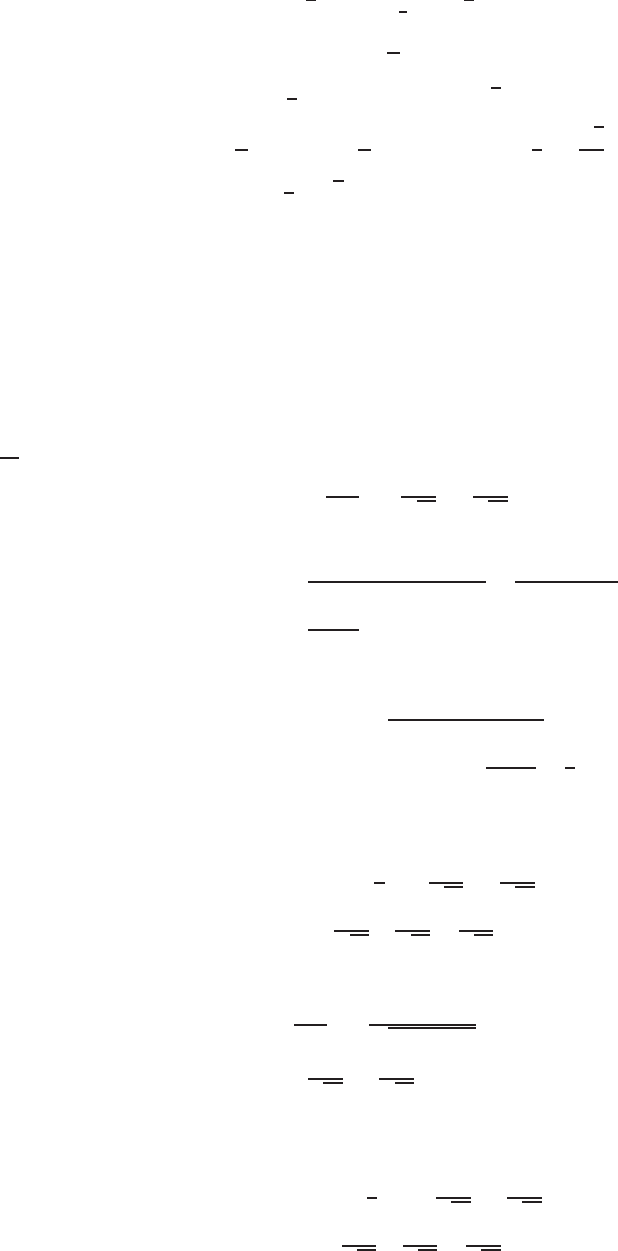
14.4 SOLUTIONS 1297
(b) The unit vector ~u2in the direction of~
i+√3~
jis ~u2=1
2(
~
i+√3~
j). From part (a),
grad f(0,π
4) = ~
i+ 2~
j .
Then the directional derivative of fat (0,π
4)in the direction of~
i+√3~
jis
f~u2(0,π
4) = grad f(0,π
4)·~u2= (
~
i+ 2~
j)·(1
2~
i+√3
2~
j)
=1
2+√3.
49. We want the directional derivative in the direction of ~u at (1,2), so we want to calculate f~u (1,2). Since fx= 2xand
fy= 2y, at the point (1,2), we have grad f(1,2) = 2
~
i+ 4~
j. Since ~u is a unit vector, we obtain
f~u (1,2) = grad f(1,2) ·~u
= (2
~
i+ 4~
j)·(0.6
~
i+ 0.8~
j)
= 2(0.6) + 4(0.8)
= 4.4.
50. (a) First we will find a unit vector in the same direction as the vector ~v = 3
~
i−2~
j. Since this vector has magnitude
√13, a unit vector is
~u 1=1
k~v k~v =3
√13
~
i−2
√13
~
j .
The partial derivatives are
fx(x, y) = (1 + x2)−(x+y)·2x
(1 + x2)2=1−x2−2xy
(1 + x2)2,
and fy(x, y) = 1
1 + x2,
then, at the point P, we have
fx(P) = fx(1,−2) = 1−12−2·1·(−2)
(1 + 12)2= 1,
fy(P) = fy(1,−2) = fy(1,−2) = 1
1 + 12=1
2.
Thus
f~u 1(P) = grad f(P)·~u 1
= (
~
i+1
2~
j)·(3
√13
~
i−2
√13
~
j)
=3
√13 −1
√13 =2
√13 .
(b) The unit vector in the same direction as the vector ~v =−~
i+ 4~
jis
~u 2=1
k~v k~v =1
p(−1)2+ 42(−~
i+ 4~
j)
=−1
√17
~
i+4
√17
~
j .
Since we have calculated from part (a) that fx(P) = 1 and fy(P) = 1/2,
f~u 2(P)= grad f(P)·~u 2
= (
~
i+1
2~
j)·(−1
√17
~
i+4
√17
~
j)
=−1
√17 +2
√17 =1
√17 .
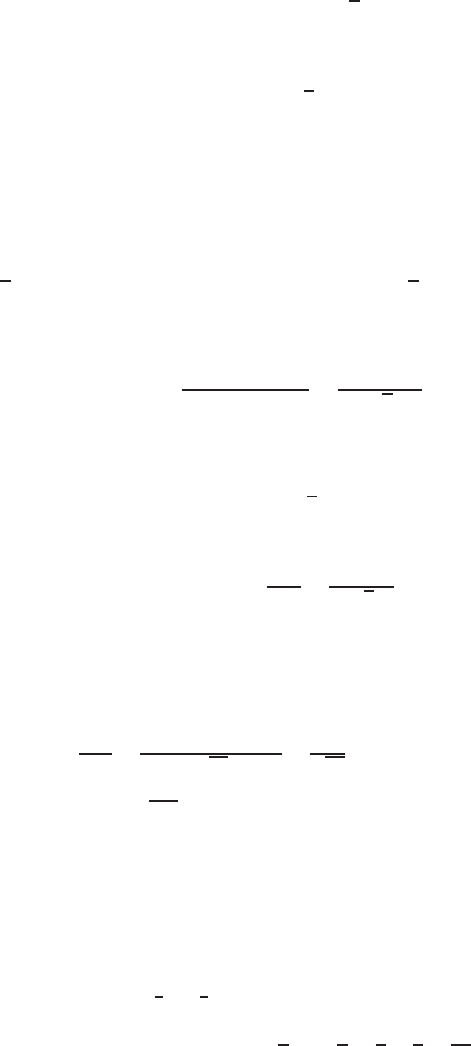
1298 Chapter Fourteen /SOLUTIONS
(c) The direction of greatest increase is grad fat P. By part (a) we have found that
fx(P) = 1 and fy(P) = 1
2.
Therefore the direction of greatest increase is
grad f(P) = ~
i+1
2~
j .
51. We have
∇f= (2xy3)
~
i+ (3x2y2)~
j .
(a) A vector in the direction of maximum rate of change is ∇f(−1,2) = −16
~
i+ 12~
j.
(b) A vector in the direction of minimum rate of change is −∇f(−1,2) = 16
~
i−12~
j.
(c) Any vector perpendicular to ∇fgives a direction in which the rate of change is zero. One possible answer is 12
~
i+
16~
j.
52. gradf(π/4,1) = (ı + )/√2. The displacement is ı + , so the direction is ı + j)/√2and the directional derivative is 1.
53. (a) The average rate of change of the function is the “rise over the run”, or the change in the z-values divided by the
horizontal distance. The vector from the point (3,1) to the point (1,2) is ~v =−2
~
i+~
j. We have
Average rate of change =f(1,2) −f(3,1)
k − 2
~
i+~
jk=1.6931 −9
√5=−3.268.
(b) The instantaneous rate of change is given by the directional derivative in the direction ~v =−2
~
i+~
j. We first find
the gradient vector:
grad f= (2x)
~
i+1
y~
j ,
so grad f(3,1) = 6
~
i+~
j. In the direction of ~v =−2
~
i+~
j,
Directional derivative = grad f·~v
k~v k=−12 + 1
√5=−4.919.
54. We see that
grad f= (3y)
~
i+ (3x+ 2y)~
j ,
so at the point (2,3), we have
grad f= 9
~
i+ 12~
j .
(a) The directional derivative is ∇f·~v
k~v k=(9)(3) + (12)(−1)
√10 =15
√10 ≈4.74.
(b) The direction of maximum rate of change is ∇f(2,3) = 9
~
i+ 12~
j.
(c) The maximum rate of change is k∇fk=√225 = 15.
55. (a) The directional derivative should be a number, not a vector.
(b) Since the partial derivatives are
fx(x, y) = 2xey, fy(x, y) = x2ey, fx(1,0) = 2, fy(1,0) = 1.
we have
grad f(1,0) = 2
~
i+~
j .
The unit vector in the direction of ~v is ~u =4
5~
i+3
5~
j. Thus, the correct answer is
f~u (1,0) = grad f(1,0) ·~u = 2 ·4
5+ 1 ·3
5=8
5+3
5=11
5.
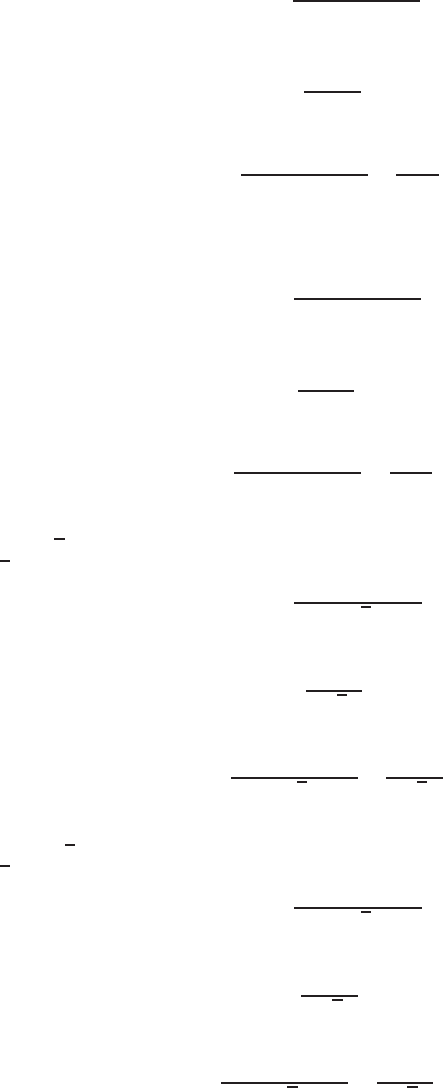
14.4 SOLUTIONS 1299
56. f~
i(4,1) means the rate of change of fin the xdirection at (4,1). Thus,
f~
i(4,1) ≈f(5,1) −f(4,1)
1.
The point (5,1) is about 2/3 of the way from the contour for f= 3 to the contour for f= 4, so we estimate f(5,1) = 3.7.
Thus
f~
i(4,1) ≈3.7−2
1= 1.7.
We can get a better estimate if we average this result with the difference quotient obtained by going the other way, that is
f~
i(4,1) ≈f(4,1) −f(3,1)
1=2−1
1= 1.
Averaging the two estimates gives f~
i(4,1) ≈1.35
57. f~
j(4,1) means the rate of change of fin the ydirection at (4,1). Thus
f~
j(4,1) ≈f(4,2) −f(4,1)
1.
The point (4,2) is about 1/3 of the way from the contour for f= 2 to the contour for f= 3, so we estimate f(4.2) = 1.3.
Thus
f~
j(4,1) ≈1.3−2
1=−0.7.
We can get a better estimate by averaging this with the difference quotient obtained by going the other way, that is,
f~
j(4,1) ≈f(4,1) −f(4,0)
1=2−4
1=−2.
Averaging the two estimates we get f~
j(4,1) ≈ −1.35.
58. Since ~u = (
~
i−~
j)/√2, we head away from the point (4,1) toward the point (5,0). Since the points (4,1) and (5,0)
are a distance √2apart,
f~u (4,1) ≈f(5,0) −f(4,1)
√2.
The point (5,0) is about half way between the contour for f= 5 and the contour for f= 6, so we estimate f(5,0) = 5.5.
Thus
f~u (4,1) ≈5.5−2
√2= 2.5.
We can get a better estimate by averaging this with the difference quotient obtained by going the other way, that is,
f~u (4,1) ≈f(4,1) −f(3,2)
√2=2−0.5
√2= 1.1
Averaging these two results gives an estimate f~u (4,1) ≈1.8.
59. Since ~u = (−~
i+~
j)/√2, we head away from the point (4,1) toward the point (3,2). Since the points (4,1) and (3,2)
are a distance √2apart,
f~u (4,1) ≈f(3,2) −f(4,1)
√2.
The point (3,2) is about half way between the point where f=and the contour for f= 1, so we estimate f(3,2) = 0.5.
Thus
f~u (4,1) ≈0.5−2
√2=−1.1
We can get a better estimate by averaging this with the difference quotient obtained by going the other way, that is,
f~u (4,1) ≈f(4,1) −f(5,0)
√2=2−5.5
√2=−2.5.
Averaging these two results gives an estimate f~u (4,1) ≈ −1.8.
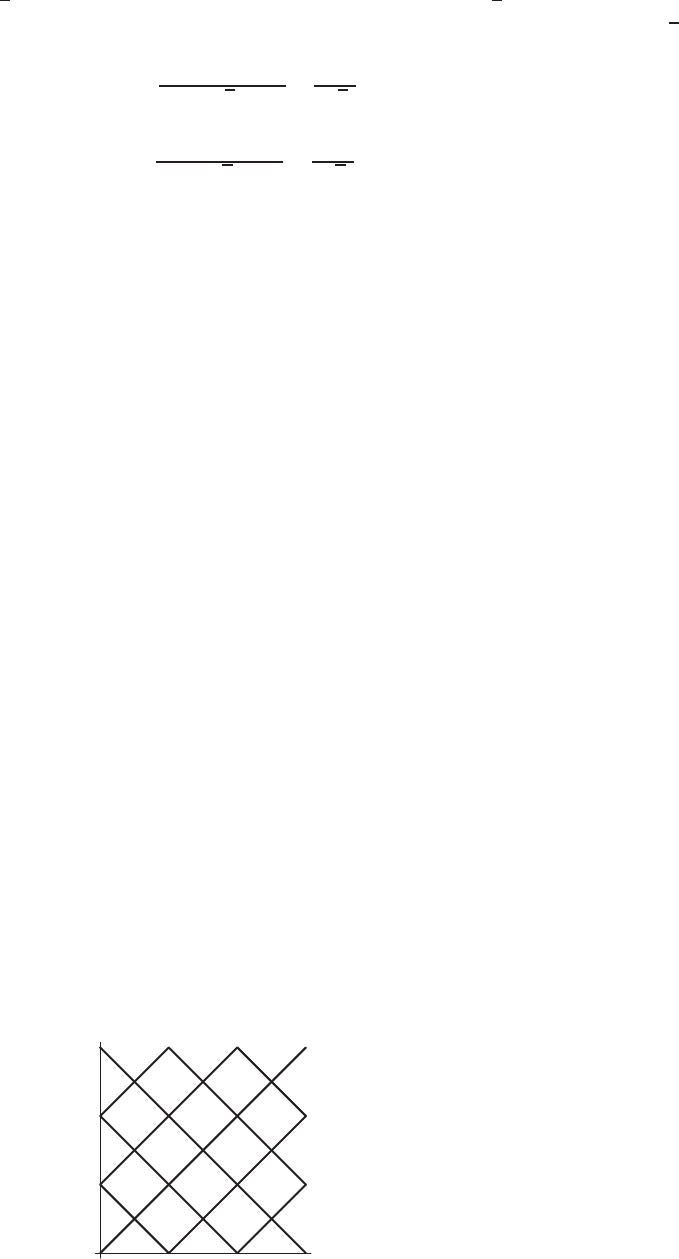
1300 Chapter Fourteen /SOLUTIONS
60. Since ~u = (−2
~
i+~
j)/√5, we head away from the point (4,1) in the direction (−2
~
i+~
j)/√5, that is, toward the point
(2,2). From the graph, we see that f(4,1) = 2 and f(2,2) = 0. Since the points (4,1) and (2,2) are a distance √5
apart, we have
f~u (4,1) ≈f(2,2) −f(4,1)
√5=0−2
√5=−0.9
We can get a better estimate by averaging this with the difference quotient obtained by going the other way, that is,
f~u (4,1) ≈f(4,1) −f(6,0)
√5=2−8
√5=−2.7.
Averaging these two results gives an estimate f~u (4,1) ≈ −1.8.
61. First, we check that 22+ 32= 13. Then let f(x, y) = x2+y2so that the given curve is the contour f(x, y) = 13. Since
fx= 2xand fy= 2y, we have grad f(2,3) = 4
~
i+ 6~
j . Since gradients are perpendicular to contours, a vector normal
to the curve at (2,3) is ~n = 4
~
i+ 6~
j. Using the normal vector to a line the same way we use the normal vector to a plane,
we get that an equation of the tangent line is 4(x−2) + 6(y−3) = 0.
62. First, we check that (2)(3) = 6. Then let f(x, y) = xy so that the given curve is the contour f(x, y) = 6. Since fx=y
and fy=x, we have grad f(2,3) = 3
~
i+ 2~
j . Since gradients are perpendicular to contours, a vector normal to the curve
at (2,3) is ~n = 3
~
i+ 2~
j. Using the normal vector to a line the same way we use the normal vector to a plane, we get that
the equation of the tangent line is 3(x−2) + 2(y−3) = 0.
63. First, we check that 3 = 22−1. Then let f(x, y) = y−x2+ 1 so that the given curve is the contour f(x, y) = 0.
Since fx=−2xand fy= 1, we have grad f(2,3) = −4
~
i+~
j . Since gradients are perpendicular to contours, a vector
normal to the curve at (2,3) is ~n =−4
~
i+ 1~
j. Using the normal vector to a line the same way we use the normal vector
to a plane, we get that an equation of the tangent line is −4(x−2) + (y−3) = 0.Notice, if we had instead found the
slope of the tangent line using dy/dx = 2x, we get (y−3) = 4(x−2), which agrees with the equation we got using the
gradient.
64. First, we check that (3 −2)2+ 2 = (2)(3) −3. Then let f(x, y) = (y−x)2−xy + 5 so that the given curve is the
contour f(x, y) = 0. Since fx=−2(y−x)−yand fy= 2(y−x)−x, we have grad f(2,3) = −5
~
i+ 0~
j . Since
gradients are perpendicular to contours, a vector normal to the curve at (2,3) is ~n =−5
~
i; in other words, the tangent
line is a vertical line. Thus the equation of the tangent line is x= 2.
65. (a) In the~
i−~
jdirection the function is decreasing, so the value of g~u (2,5) is negative.
(b) In the~
i+~
jdirection the function is decreasing, so the value of g~u (2,5) negative as well.
66. At the point (1.2,0), the value of the function is 4.2. Nearby, the largest value is 8.9at the point (1.4,−1). Since the
gradient vector points in the direction of maximum increase, it points into the fourth quadrant.
67. (a) Negative. ∇fis perpendicular to the level curve at the point P, so its x-component which is ∇f·~
iis negative.
(b) Positive. The y-component of ∇fis in the same direction as ~
jat Pand hence the dot product will be positive.
(c) Positive. The partial derivative with respect to xat Qis positive because the value of fis increasing in the positive x
direction at Q. (Note that Qlies between the level curves with values 3 and 4 and that the one with value 4 is further
in the positive xdirection from Q.)
(d) Negative. Again, Qlies between the level curves with values 3 and 4 and the one with value 3 is further from Qin
the positive ydirection, so the partial derivative with respect to yat Qis negative.
68. k∇fkat Pis larger because the level curves are closer there.
69. At points (x, y)where the gradients are defined and are not the zero vector, the level curves of fand gintersect at right
angles if and only grad f·grad g= 0.
We have grad f·grad g= (
~
i+~
j)·(
~
i−~
j) = 0.The level curves of fand gare straight lines that cross at right
angles. See Figure 14.14.
x
yg=c2
f=c1
Figure 14.14

14.4 SOLUTIONS 1301
70. At points (x, y)where the gradients are defined and are not the zero vector, the level curves of fand gintersect at right
angles if and only grad f·grad g= 0.
We have grad f·grad g= (2
~
i+ 3~
j)·(2
~
i−3~
j) = −56= 0.The level curves of fand gare straight lines that do
not cross at right angles. See Figure 14.15.
x
yg=c2
f=c1
Figure 14.15
71. At points (x, y)where the gradients are defined and are not the zero vector, the level curves of fand gintersect at right
angles if and only grad f·grad g= 0.
We have grad f·grad g= (2x
~
i−~
j)·((1/x)
~
i+ 2~
j) = 0 at all points where both functions are defined. The level
curves of fare parabolas that intersect the level curves of gin right angles. See Figure 14.16.
x
y
g=c2
f=c1
Figure 14.16
72. At points (x, y)where the gradients are defined and are not the zero vector, the level curves of fand gintersect at right
angles if and only grad f·grad g= 0.
We have grad f·grad g= (2x
~
i−2y~
j)·(y~
i+x~
j) = 0.The level curves of fand gare hyperbolas that cross at
right angles except at the point (0,0). See Figure 14.17.
x
■
f=c1
g=c2
y
Figure 14.17
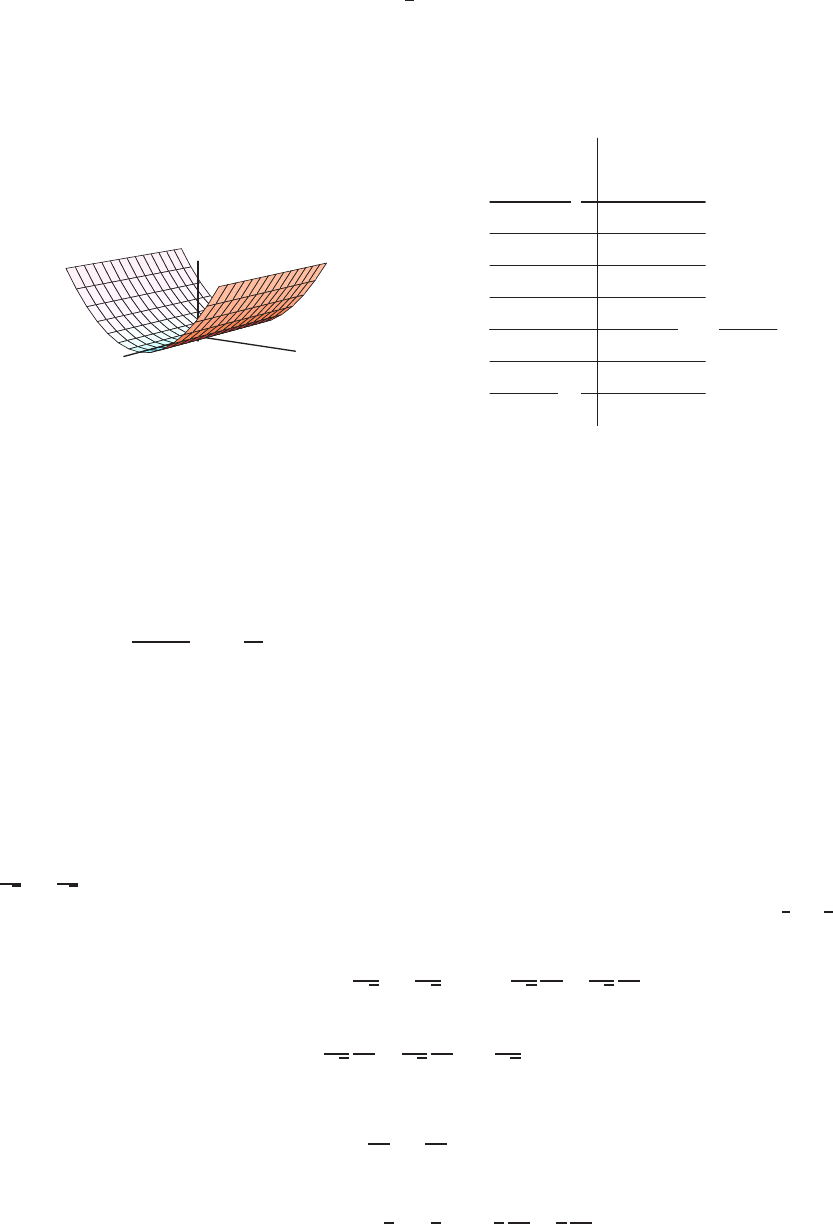
1302 Chapter Fourteen /SOLUTIONS
73. (a) The graph of z=y2is in Figure 14.18.
(b) If z=c, then y2=c, so the level curves are y=±√c. See Figure 14.19.
(c) The level curves in part (b) show that the direction of the greatest increase is in the ydirection if the point is in the
upper half xy-plane (where y > 0). Since the point (2,3,9) is in the upper half xy-plane, we climb fastest in the
direction ~
j, parallel to the y-axis.
xy
z
Figure 14.18
z= 4
z= 1
z= 0
z= 1
z= 4
z= 9
z= 16
4
−2
x
y
Figure 14.19
74. (a) The fastest descent is in the direction of −∇f, so
−∇f(1,3) = (4x
~
i+ 2y~
j)(1,3)
= 4
~
i+ 6~
j .
Any positive multiple of this vector points in the same direction.
(b) If you start to move in this direction, the slope of the path is the rate of change in your height with distance, which is
−||∇f|| =−√42+ 62=−√52.
75. (a) We have f(x, y) = Cfor points (x, y)at a distance Cfrom P, points on the circle of radius Ccentered at P. The
level curves of fare circles centered at P
(b) The gradient of fat the point (x, y)points in the direction that you should move that point to increase its distance
from Pmost rapidly, away from Pon the line from Pthrough (x, y). The vector grad fpoints directly away from
Pat every point.
(c) The magnitude kgrad f(x, y)kis the rate change of fas you go in the direction of grad g(x, y), which is directly
away from P. Every unit farther away from Pincreases fby 1 because fis the distance from P, so kgrad f(x, y)k=
1.
76. The vector from (2,1) to (1,3) is ~v1= (1 −2)
~
i+ (3 −1)~
j=−~
i+ 2~
j. A unit vector in this direction is ~u1=
−1
√5~
i+2
√5~
j.
A vector from (2,1) to (5,5) is ~v2= (5 −2)
~
i+ (5 −1)~
j= 3
~
i+ 4~
j. A unit vector in this direction is ~u2=3
5~
i+4
5~
j.
The directional derivative along ~u1is
z~u1(1,2) = ∇z·−1
√5
~
i+2
√5
~
j=−1
√5
∂z
∂x +2
√5
∂z
∂y .
So
−1
√5
∂z
∂x +2
√5
∂z
∂y =−2
√5,
that is,
(1)
−∂z
∂x + 2 ∂z
∂y =−2.
The directional derivative along ~u2is
z~u2(1,2) = ∇z·3
5~
i+4
5~
j=3
5
∂z
∂x +4
5
∂z
∂y ,
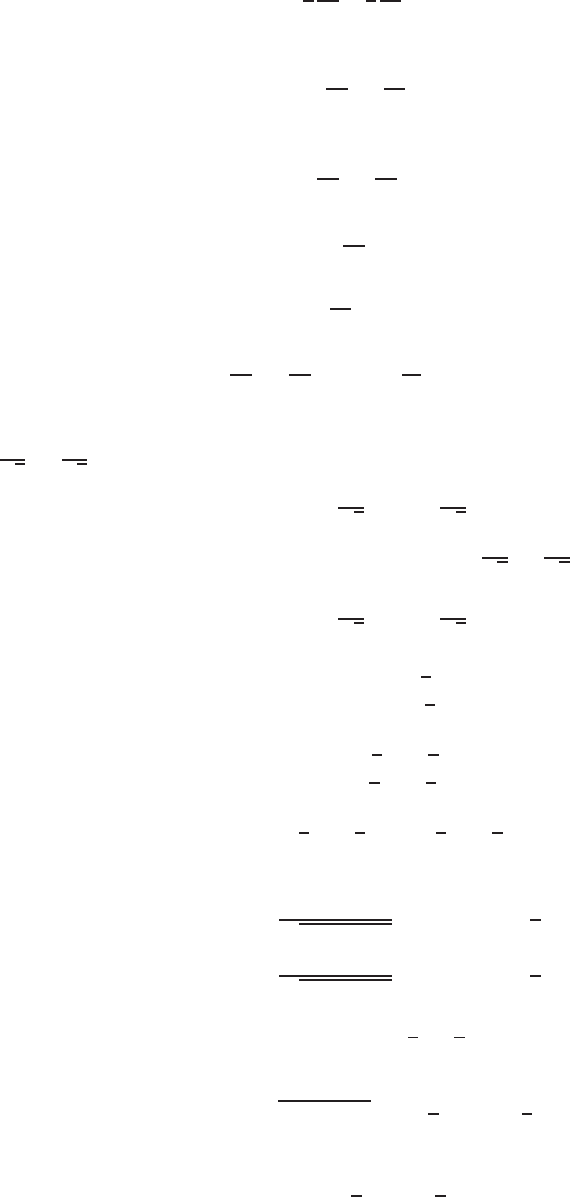
14.4 SOLUTIONS 1303
so 3
5
∂z
∂x +4
5
∂z
∂y = 1,
that is,
(2)
3∂z
∂x + 4 ∂z
∂y = 5.
Now we solve the system of equations (1) and (2). Multiplying equation (1) by 3 gives
(3)
−3∂z
∂x + 6 ∂
∂y =−6.
Adding (2) and (3) we get:
10 ∂z
∂y =−1.
So ∂z
∂y =−0.1
and from equation (1)
∂z
∂x = 2 ∂z
∂y + 2 = 2(−1
10 ) + 2 = 1.8.
77. Directional derivative = ∇f·~u , where ~u =unit vector. If we move from (4,5) to (5,6), we move in the direction~
i+~
j
so ~u =1
√2
~
i+1
√2
~
j. So,
∇f·~u =fx1
√2+fy1
√2= 2.
Similarly, if we move from (4,5) to (6,6), the direction is 2
~
i+~
jso ~u =2
√5
~
i+1
√5
~
j . So
∇f·~u =fx2
√5+fy1
√5= 3.
Solving the system of equations for fxand fy
fx+fy= 2√2
2fx+fy= 3√5
gives
fx= 3√5−2√2
fy= 4√2−3√5.
Thus at (4,5),
∇f= (3√5−2√2)
~
i+ (4√2−3√5)~
j .
78. (a) We have
gx=x
px2+ 3y+ 3 ,so gx(1,4) = 1
4
gy=3/2
px2+ 3y+ 3 ,so gy(1,4) = 3
8
grad g(1,4) = 1
4~
i+3
8~
j .
(b) Using the value g(1,4) = 4 and the partial derivatives in part (a) we have
g(x, y) = px2+ 3y+ 3 ≈4 + 1
4(x−1) + 3
8(y−4).
(c) Using the linearization in part (b), we have
g(1.01,3.98) ≈4 + 1
4(0.01) + 3
8(−0.02) = 3.995.

1304 Chapter Fourteen /SOLUTIONS
79. fx= 2x,fy=−2y, so grad f(3,−1) = 6
~
i+ 2~
j. For the direction θ=π/4, the direction is ~u =1
√2~
i+1
√2~
j, so
f~u (3,−1) = (6
~
i+ 2~
j)·(1
√2~
i+1
√2~
j) = 8
√2= 4√2.
The directional derivative is largest in the direction of the gradient vector grad f(3,−1) = 6
~
i+ 2~
j.
80. The temperature (Fahrenheit) as a function of position yin miles and time tin hours is given by
H=f(y, t) = 30 −0.05y−5t.
At time tthe moose is at position y= 20t+Cwhere Cis an unknown constant that depends on where the moose was at
t= 0. At time tthe moose perceives temperature H=g(t) = f(20t+C, t). The rate of change, g′(t), of temperature
with time, can be evaluated with the chain rule:
g′(t) = ∂f
∂y ·dy
dt +∂f
∂t =−0.05(20) −5 = −6◦/hour.
81. Assume that the x-axis points east and the y-axis points north. We are given that k∇fk= 5 and that ∇fis in the direction
~
i+~
j. Since k~
i+~
jk=√2and ∇fis a multiple of~
i+~
j, we have
∇f=5
√2(
~
i+~
j).
The rate of change toward the north is the directional derivative in direction ~
j, which is
∇f·~
j=5
√2(
~
i+~
j)·~
j=5
√2.
82. Let’s put a coordinate plane on the area you are hiking, with your trail along the x-axis and the second trail branching off
at the origin as in Figure 14.20. You are moving in the positive xdirection. Let h(x, y)be the elevation at the point (x, y)
on the mountain.
30◦
Branch trail
Your trail
x
y
Figure 14.20
: Two trails
Since the trail along the x-axis ascends at a 20◦angle, we have hx(0,0) = tan 20◦. Since the trail is the steepest
path, grad hmust point along your trail in the positive xdirection. Thus
grad h=hx
~
i+ 0~
j= tan 20◦~
i .
We must compute the rate of change of elevation in the direction of the branch trail. The unit vector in this direction
is ~u = cos 30◦~
i+ sin 30◦~
j, and thus the directional derivative is
h~u = (grad h)·~u = (tan 20◦~
i)·(cos 30◦~
i+ sin 30◦~
j) = (tan 20◦)(cos 30◦) = 0.3152.
The angle of ascent of the branch trail is thus tan−1(0.3152) = 17.5◦.
83. (a) Pcorresponds to greatest rate of increase of fand Qcorresponds to greatest rate of decrease of f. See Figure 14.21.
(b) The points are marked in Figure 14.22.
(c) Amplitude is kgrad fk. The equation is
f~u =kgrad fkcos θ.
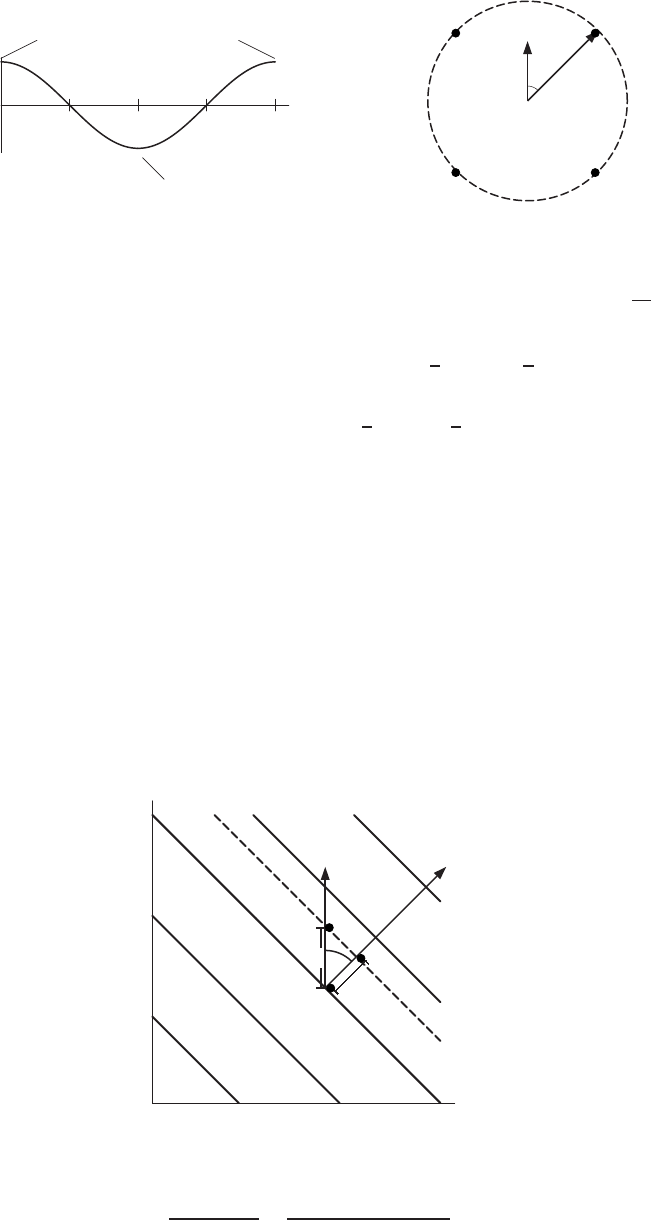
14.4 SOLUTIONS 1305
R
PQ S P θ
f~u
Greatest rate of increase
of
f
in direction of
P
✙ ❥
■
Greatest rate of decrease
of
f
in direction of
Q
Figure 14.21
S
(Zero
f~u
)
P
(Max
f~u
)
R
(Zero
f~u
)
Q
(Min
f~u
)
grad f
~u θ
Figure 14.22
84. (a) Since f(x, y) = 5y−x2−y2,we have ∇f(x, y) = −2x~
i+ (5 −2y)~
j , so ∇f(1,1) = −2~
i+ 3~
j , which is
the direction of steepest ascent. Therefore, the initial rate of steepest ascent is k∇f(1,1)k=√13 meters ascended
for each horizontal meter covered.
(b) In order to go straight northwest, we want to travel along the vector ~v =−~
i+~
j . A unit vector that points in the
same direction as ~v is therefore given by ~u =~v /k~v k=−(1/√2)~
i+ (1/√2)~
j, so
f~u (1,1) = ∇f(1,1) ·~u
= (−2)(−1/√2) + 3(1/√2) = 3.54
meters ascended for each horizontal meter traveled.
(c) Here, we are being asked to determine vectors ~u such that f~u (1,1) = 0.Since f~u (1,1) = 0 if and only if
(−2
~
i+ 3~
j)·(u1
~
i+u2~
j) = 0 or −2u1+ 3u2= 0,we see by inspection that ~u = 3
~
i+ 2~
jand ~u =−3
~
i−2~
j
give the two possible directions.
85. (a) To estimate the change in f, we use the gradient vector to estimate the change in fin moving from Pto Q. Because
the contours are approximately parallel, moving from Pto Qtakes you to the same contour as moving from Pto R.
(See Figure 14.23.) If θis the angle between ~u and grad f(a, b), then
Change in f
between Pand Q=Change in f
= Rate of change
in direction P R ! Distance traveled
between Pand R!
≈ kgrad fk(hcos θ).
✛
✛
hcos θ
✻
❄
h
Q
~u
θ
grad f
P= (a, b)
R
Figure 14.23
(b) Since ~u is a unit vector, we use the definition of f~u (a, b)to estimate
f~u (a, b)≈Change in f
h≈kgrad f(a, b)khcos θ
h
=kgrad f(a, b)kcos θ=kgrad fkk~u kcos θ= grad f(a, b)·~u .
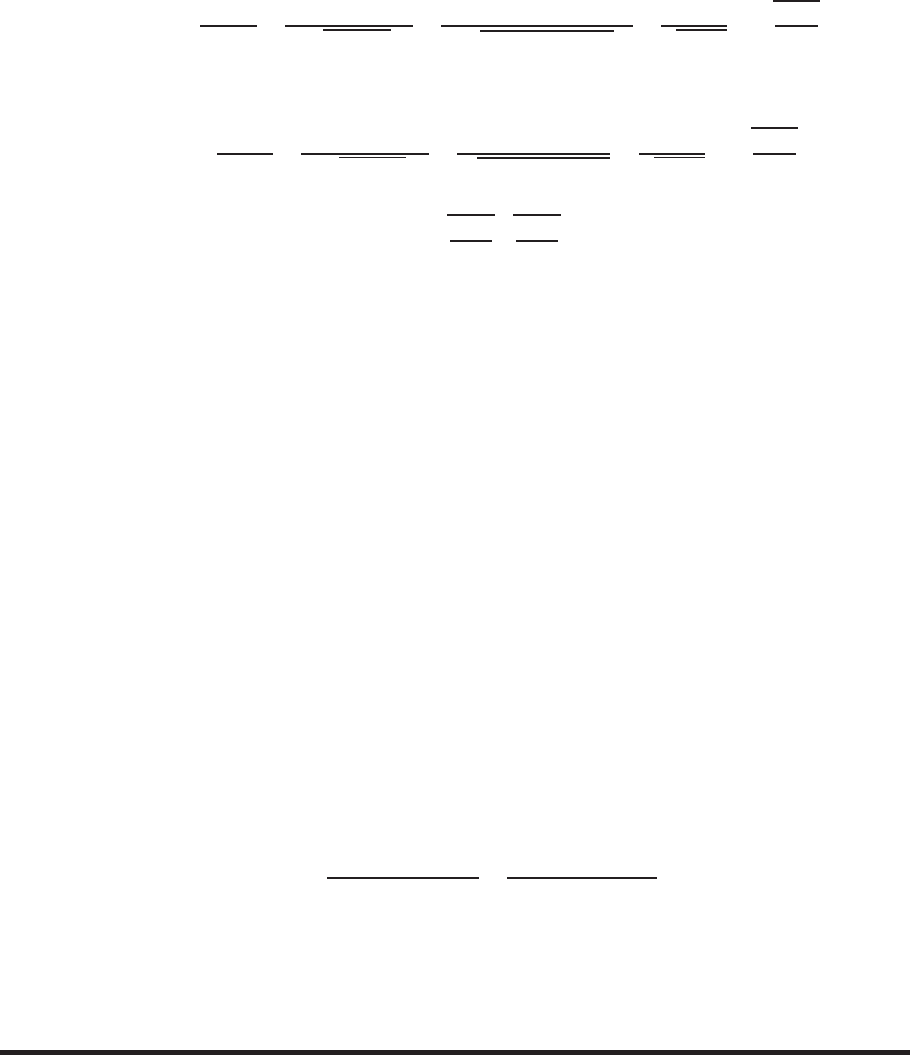
1306 Chapter Fourteen /SOLUTIONS
This approximation gets better as we choose hsmaller and smaller, and in the limit we get the formula:
f~u (a, b) = grad f(a, b)·~u .
86. (a) The ellipse is a level curve of the function f(x, y) = x2/2 + y2. The vector grad f=x
~
i+ 2y~
jis perpendicular
to the contours of fat the point (x, y). Thus, the vector ~w =a
~
i+ 2b~
jis perpendicular to the line Ltangent to the
ellipse at the point (a, b).
(b) Let ~u be the vector from P= (−1,0) to (a, b), so ~u = (a+ 1)
~
i+b~
j. The distance from Pto the line is
p=|~u ·~w |
k~w k=a(a+1) + 2b2
√a2+ 4b2=|a(a+ 1) + 2(1 −a2/2)|
pa2+ 4(1 −a2/2) =|2 + a|
√4−a2=r2 + a
2−a
where the last equality follows from the substitution b2= 1 −a2/2and the fact that |a|<2.
(c) Let ~v be the vector from Q= (1,0) to (a, b), so ~v = (a−1)
~
i+b~
j. The distance from Qto Lis
q=|~v ·~w |
k~w k=a(a−1) + 2b2
√a2+ 4b2=|a(a−1) + 2b2|
pa2+ 4(1 −a2/2) =|2−a|
√4−a2=r2−a
2 + a.
(d) We have
pq =r2 + a
2−ar2−a
2 + a= 1.
87. (a) Let ~v =−fy(a, b)
~
i+fx(a, b)~
j. Then ~v 6= 0 because grad f6= 0. Since ~v ·grad f(a, b) = (−fy(a, b)
~
i+
fx(a, b)~
j)·(fx(a, b)
~
i+fy(a, b)~
j) = 0 we see that the vector ~v is perpendicular to grad f(a, b). The contour Cis
perpendicular to grad f(a, b)at the point (a, b)by the geometric property of the gradient vector. Since the vector ~v
and the contour Cat (a, b)are both perpendicular to the same vector they are parallel to each other, which is another
way of saying that ~v is tangent to Cat (a, b).
(b) A line parallel to a vector r
~
i+s~
jwith r6= 0 has slope s/r. By part (a) the line tangent to Cat (a, b)is parallel to
~v =r
~
i+s~
jwhere r=−fy(a, b)and s=fx(a, b). If the tangent line is not vertical, then fy(a, b)6= 0. Thus the
tangent line has slope s/r =−fx(a, b)/fy(a, b).
88. The direction of most rapid increase of the sum f+gis given by the vector grad(f(x, y) + g(x, y)) = grad f(x, y) +
grad g(x, y).
(a) A unit vector in the direction of ~w is the vector ~u =~w /k~w k. The rates of change of fand gin the direction of ~w
are the directional derivatives
f~u (x, y) = grad f(x, y)·~u = grad f(x, y)·~w /k~w k
g~u (x, y) = grad g(x, y)·~u = grad g(x, y)·~w /k~w k.
The two directional derivatives are equal because
grad f(x, y)·~w = grad f(x, y)·(grad f(x, y) + grad g(x, y))
=kgrad f(x, y)k2+ grad f(x, y)·grad g(x, y)
=kgrad g(x, y)k2+ grad f(x, y)·grad g(x, y)
= grad g(x, y)·(grad f(x, y) + grad g(x, y))
= grad g(x, y)·~w
(b) From the calculation in the solution to part (a), we have grad f(x, y)·~w = grad g(x, y)·~w . Since kgrad f(x, y)k=
kgrad g(x, y)kwe have
grad f(x, y)·~w
kgrad f(x, y)kk~w k=grad g(x, y)·~w
kgrad g(x, y)kk~w k
which shows that the angle between ~w and grad f(x, y)is the same as the angle between ~w and grad g(x, y). Since
grad f(x, y)is perpendicular to the contour of fthrough Pand grad g(x, y)is perpendicular to the contour of g
through P, this shows the ~w makes equal angles with the two contours. Thus ~w bisects the angle between the two
contours.
Strengthen Your Understanding
89. Directional derivatives are scalars, not vectors.
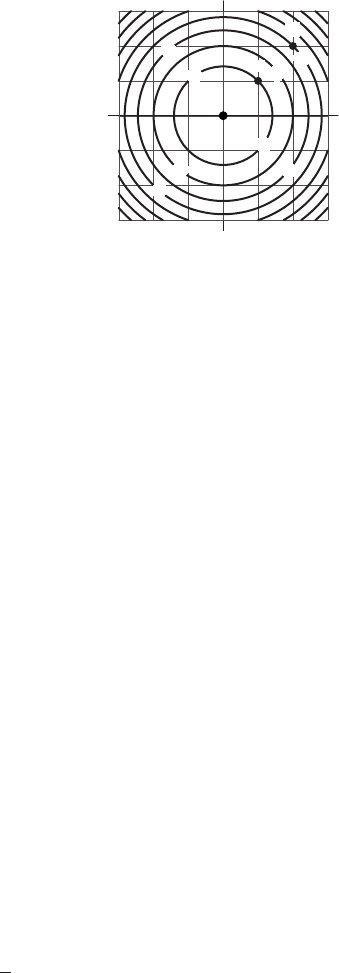
14.4 SOLUTIONS 1307
90. Gradients are vectors, not scalars.
91. The closer together the contours, the longer the gradient vector.
92. We have
f~u (0,0) = ~u ·gradf(0,0) = ~u ·2
~
i+3~
j.
Many unit vectors make this dot product negative, for example ~u =−ior ~u =−j.
93. A possible answer is in Figure 14.24, where the gradient at Pis shorter than the gradient at Qbecause the contours are
closer at Qthan at P.
321−1−2−3
3
2
1
−1
−2
−3
P
Q
x
y
4
4
2
2
6
6
8
8
Figure 14.24
94. (a) The gradient vector ∇f(P)is perpendicular to the contour of fthat goes through the point P. It points in the
direction of maximal positive rate of change of fat the point P.
(b) The magnitude k∇f(P)kis the directional derivative of fat the point Pin the direction of the gradient vector
∇f(P)itself. Thus the magnitude equals the maximum directional rate of change of fat the point P.
(c) Given a unit vector ~u , the dot product ∇f(P)·~u equals the directional derivative f~u (P)of fat the point Pin the
direction of ~u .
95. False. For example, suppose fis the linear function f(x, y) = x+y. Then fx=fy= 1 at all points. Consider the
contour f= 1, which is the line x+y= 1 of slope −1. There is no point on this contour where the slope is fy/fx= 1.
96. False. The gradient vector of a function of two variables, f(x, y), is a vector in 2-space given by fx(a, b)
~
i+fy(a, b)~
j.
97. False. Left side is a vector, right side is a scalar.
98. False. The gradient is perpendicular to the contour of fat (a, b).
99. True. If ~u is a unit vector, then the directional derivative is given by the formula f~u (a, b) = grad f(a, b)·~u .
100. True. The components of the gradient vector are the xand ypartial derivatives, fx(a, b)and fy(a, b). These are the
directional derivatives of fin the~
iand ~
jdirections, respectively.
101. False. The directional derivative is a scalar, not a vector.
102. False. The gradient vector at (3,4) has no relation to the direction of the vector 3
~
i+4~
j. For example, if f(x, y) = x+2y,
then grad f=~
i+ 2~
j, which is not perpendicular to 3
~
i+ 4~
j. The gradient vector grad f(3,4) is perpendicular to the
contour of fpassing through the point (3,4).
103. True. The gradient points in the direction of maximal increase of f, and the opposite direction gives the direction of
maximum decrease for f.
104. False. The gradient points in the direction of greatest local maximum increase. This means that fincreases in the ~
i
direction only near the point (1,2). We cannot conclude that fkeeps increasing in that direction as far away from (1,2)
as (10,2).
105. True. The length of the gradient gives the maximal rate of increase. We have grad g(3,0) = 6
~
iand grad h(3,0) = 6~
j,
so kgrad g(3,0)k=kgrad h(3,0)k= 6.
106. True. The length of the gradient gives the maximal directional derivative in any direction. The gradient vector is grad f(0,0) =
~
i+~
j, which has length √2.
107. True. It is the rate of change of fin the direction of ~u at the point (x0, y0).

1308 Chapter Fourteen /SOLUTIONS
108. False. f~u (a, b) = k∇f(a, b)kcos θ, where θis the angle between grad fand ~u .
109. Must be true, because at any point grad fis perpendicular to level curves through that point.
110. True. Take the direction perpendicular to grad fat that point. If grad f= 0, any direction will do.
111. Is never true. If kgrad fk= 0, then grad f= 0, so grad f·~u = 0 for any unit vector ~u . Thus the directional derivative
must be zero.
Solutions for Section 14.5
Exercises
1. Since fx= 2x,fy= 0 and fz= 0, we have
grad f= 2x
~
i .
2. We have fx= 2x,fy= 3y2, and fz=−4z3. Thus
grad f= 2x
~
i+ 3y2~
j−4z3~
k .
3. Since f(x, y, z) = ex+y+z=exeyez,we have fx=exeyez,fy=exeyezand fz=exeyez, so
grad f=exeyez(
~
i+~
j+~
k).
4. Since fx=−sin(x+y),fy=−sin(x+y) + cos(y+z),fz= cos(y+z), we have
grad f=−sin(x+y)
~
i+ (cos(y+z)−sin(x+y))~
j+ cos(y+z)~
k .
5. Since fx=−2xyz2/(1 + x2)2,fy=z2/(1 + x2), and fz= 2yz/(1 + x2),
grad f=−2xyz2
(1 + x2)2~
i+z2
1 + x2~
j+2yz
1 + x2~
k .
6. We have fx=−2x/(x2+y2+z2)2,fy=−2y/(x2+y2+z2)2, and fz=−2z/(x2+y2+z2)2. Thus
grad f=−2
(x2+y2+z2)2(x
~
i+y~
j+z~
k).
7. We have fx=x/px2+y2+z2,fy=y/px2+y2+z2, and fz=z/px2+y2+z2. Thus
grad f=1
px2+y2+z2(x
~
i+y~
j+z~
k).
8. We have fx=eysin z,fy=xeysin z, and fz=xeycos z. Thus
grad f=eysin z~
i+xeysin z~
j+xeycos z~
k .
9. Since fx=y, fy=x, and fz=ezcos (ez),
grad f=y~
i+x~
j+ezcos (ez)~
k .
10. Since fx1= 2x1x3
2x4
3,fx2= 3x2
1x2
2x4
3,fx3= 4x2
1x3
2x3
3,we have
grad f= (2x1x3
2x4
3)
~
i+ (3x2
1x2
2x4
3)~
j+ (4x2
1x3
2x3
3)~
k .
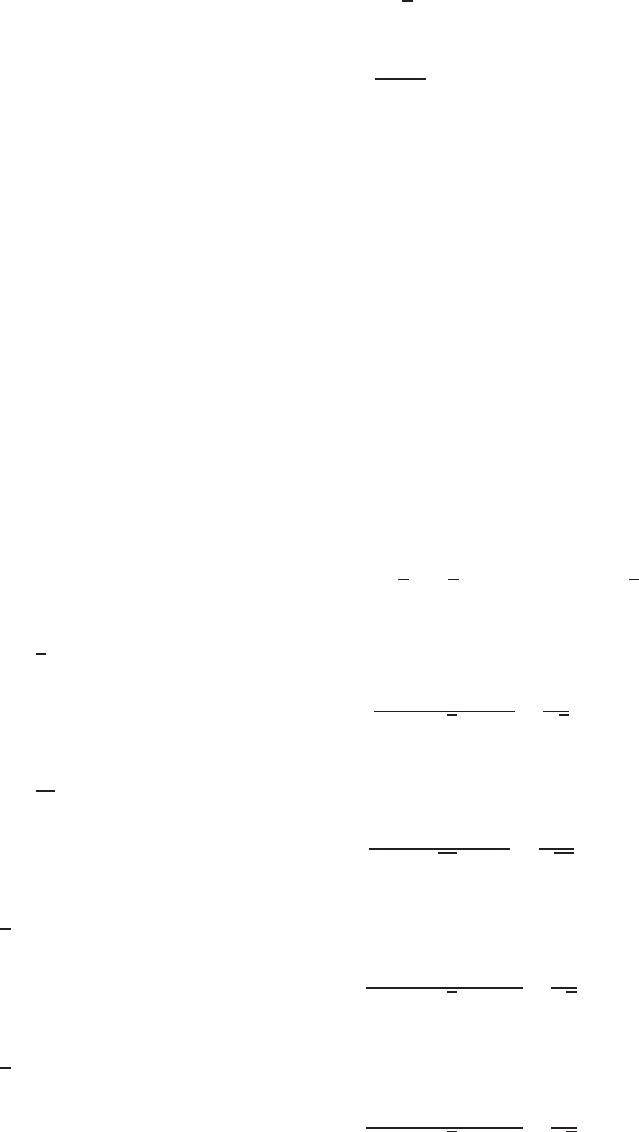
14.5 SOLUTIONS 1309
11. Since fp=ep,fq= 1/q,fr= 2rer2, we have
grad f=ep
~
i+1
q~
j+ 2rer2~
k.
12. We have
grad(ez2+yln(x2+ 5)) = y2x
x2+ 5~
i+ ln(x2+ 5)~
j+ 2zez2~
k .
13. We have fx= 0,fy= 2yz and fz=y2.Thus grad f= 2yz~
j+y2~
kand grad f(1,0,1) = ~
0.
14. We have fx= 2,fy= 3 and fz= 4 so grad f= 2
~
i+ 3~
j+ 4~
kat all points.
15. We have
grad(x2+y2−z4)(3,2,1)
= 2x
~
i+ 2y~
j−4z3~
k(3,2,1)
= 6
~
i+ 4~
j−4~
k .
16. We have fx=yz,fy=xz, and fz=yz. Thus fx(1,2,3) = 6,fy(1,2,3) = 3, and fz(1,2,3) = 2, so
grad f= 6
~
i+ 3~
j+ 2~
k .
17. We have
grad(sin(xy) + sin(yz))(1,π,−1)
=ycos(xy)
~
i+ (xcos(xy) + zcos(yz))~
j+ycos(yz)~
k(1,π,−1)
=−π~
i−π~
k .
18. We have
grad(xln(yz))(2,1,e)
= ln(yz)
~
i+x
y~
j+x
z~
k(2,1,e)
=~
i+ 2~
j+2
e~
k .
19. We have grad f=y~
i+x~
j+ 2z~
k, so grad f(1,2,3) = 2
~
i+~
j+ 6~
k. A unit vector in the direction we want is
u= (1/√3)(
~
i+~
j+~
k). Therefore, the directional derivative is
grad f(1,2,3) ·~u =2·1 + 1 ·1 + 6 ·1
√3=9
√3.
20. We have grad f=y~
i+x~
j+ 2z~
k, so grad f(1,1,1) = ~
i+~
j+ 2~
k. A unit vector in the direction we want is
u= (1/√14)(
~
i+ 2~
j+ 3~
k). Therefore, the directional derivative is
grad f(1,1,1) ·~u =1·1 + 1 ·2 + 2 ·3
√14 =9
√14 .
21. We have grad f=y~
i+x~
j+ 2z~
k, so grad f(1,1,0) = ~
i+~
j. A unit vector in the direction we want is u=
(1/√2)(−~
i+~
k). Therefore, the directional derivative is
grad f(1,1,0) ·~u =1(−1) + 1 ·0 + 0 ·1
√2=−1
√2.
22. We have grad f=y~
i+x~
j+ 2z~
k, so grad f(0,1,1) = ~
i+ 2~
k. A unit vector in the direction we want is u=
(1/√2)(−~
i+~
k). Therefore, the directional derivative is
grad f(0,1,1) ·~u =1(−1) + 0 ·0 + 2 ·1
√2=1
√2.

1310 Chapter Fourteen /SOLUTIONS
23. We have grad f=y~
i+x~
j+ 2z~
k, so grad f(2,3,4) = 3
~
i+ 2~
j+ 8~
k. Let ~u be a unit vector making an angle of
3π/4with grad f(2,3,4). Then, the directional derivative is
grad f(2,3,4) ·~u =kgrad f(2,3,4)kk~u kcos 3π
4=√77(1) −1
√2=−r77
2.
24. We have grad f=y~
i+x~
j+ 2z~
k, so grad f(2,3,4) = 3
~
i+ 2~
j+ 8~
k. The maximum rate of change of fat (2,3,4) is
in the direction of grad f(2,3,4) and the directional derivative in that direction is the maximum rate of change, namely
kgrad f(2,3,4)k=√77.
25. First, we check that (−1)2−(1)2+ 22= 4. Then let f(x, y, z) = x2−y2+z2so that the given surface is the level
surface f(x, y, z) = 4. Since fx= 2x,fy=−2y, and fz= 2z, we have grad f(−1,1,2) = −2
~
i−2~
j+ 4~
k . Since
gradients are perpendicular to level surfaces, a vector normal to the surface at (−1,1,2) is ~n =−2
~
i−2~
j+ 4~
k. Thus
an equation for the tangent plane is
−2(x+ 1) −2(y−1) + 4(z−2) = 0.
26. First, we check that 2 = (−1)2+ (1)2. Then let f(x, y, z) = z−x2−y2so that the given surface is the level surface
f(x, y, z) = 0. Since fx=−2x,fy=−2y, and fz= 1, we have grad f(−1,1,2) = 2
~
i−2~
j+~
k . Since gradients
are perpendicular to level surfaces, a vector normal to the surface at (−1,1,2) is ~n = 2
~
i−2~
j+~
k. Thus an equation
for the tangent plane is
2(x+ 1) −2(y−1) + (z−2) = 0.
Note that you could also view the surface as the graph of the function z=g(x, y) = x2+y2and get the equation of the
tangent plane using the local linearization of g.
27. First, we check that 1 = 22−3. Then we let f(x, y, z) = y2−z2+ 3, so that the given surface is the level surface
f(x, y, z) = 0. Since fx= 0,fy= 2y, and fz=−2z, we have grad f(−1,1,2) = 2~
j−4~
k . Since gradients are
perpendicular to level surfaces, a vector normal to the surface at (−1,1,2) is ~n = 2~
j−4~
k. Thus an equation for the
tangent plane is
2(y−1) −4(z−2) = 0.
28. First, we check that (−1)2−(−1)(1)(2) = 3. Then let f(x, y, z) = x2−xyz so that the given surface is the level
surface f(x, y, z) = 3. Since fx= 2x−yz,fy=−xz, and fz=−xy, we have grad f(−1,1,2) = −4
~
i+ 2~
j+~
k .
Since gradients are perpendicular to level surfaces, a vector normal to the surface at (−1,1,2) is ~n =−4
~
i+ 2~
j+~
k.
Thus an equation for the tangent plane is
−4(x+ 1) + 2(y−1) + (z−2) = 0.
29. First, we check that cos(−1 + 1) = e−2+2. Then we let f(x, y, z) = cos(x+y)−exz+2, so that the given surface
is the level surface f(x, y, z) = 0. Since fx=−sin(x+y)−zexz+2,fy=−sin(x+y), and fz=−xexz+2, we
have grad f(−1,1,2) = −2
~
i+~
k . Since gradients are perpendicular to level surfaces, a vector normal to the surface at
(−1,1,2) is ~n =−2
~
i+~
k. Thus an equation for the tangent plane is
−2(x+ 1) + (z−2) = 0.
30. First, we check that 1 = 4/(2(−1) + 3(2)). We could let f(x, y, z) = y−4/(2x+ 3y), but instead let’s try f(x, y, z) =
y(2x+ 3z)so that the given surface is the level surface f(x, y, z) = 4. Since fx= 2y,fy= 2x+ 3z, and fz= 3y,
we have grad f(−1,1,2) = 2
~
i+ 4~
j+ 3~
k . Since gradients are perpendicular to level surfaces, a vector normal to the
surface at (−1,1,2) is ~n = 2
~
i+ 4~
j+ 3~
k. Thus an equation for the tangent plane is
2(x+ 1) + 4(y−1) + 3(z−2) = 0.
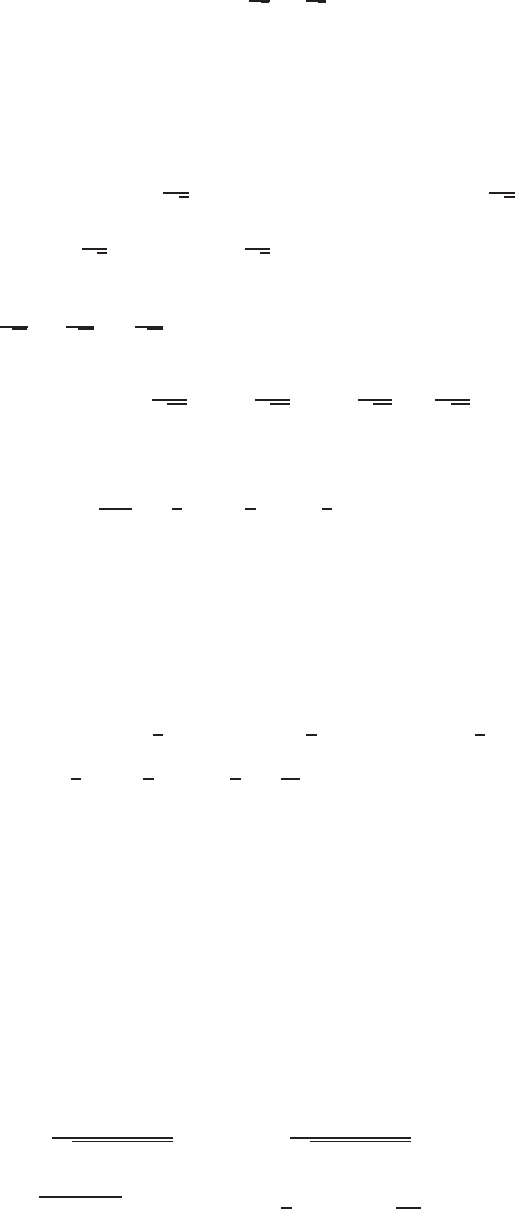
14.5 SOLUTIONS 1311
31. (a) The unit vector ~u 1in the direction of ~v 1=~
i−~
kis ~u 1=1
√2~
i−1
√2~
k. We have
fx(x, y, z) = 6xy2,and fx(−1,0,4) = 0
fy(x, y, z) = 6x2y+ 2z, and fy(−1,0,4) = 8
fz(x, y, z) = 2y, and fz(−1,0,4) = 0.
So,
f~u 1(−1,0,4) = fx(−1,0,4) 1
√2+fy(−1,0,4)(0) + fz(−1,0,4) −1
√2
= 0 1
√2+ 8(0) + 0 −1
√2
= 0.
(b) The unit vector ~u 2=−1
√19~
i+3
√19~
j+3
√19 ~
kis in the direction of ~v 2=−~
i+ 3~
j+ 3~
k. Using the partial
derivatives from part (a),
f~u 2(−1,0,4) = 0 −1
√19 + 8 3
√19 + 0 3
√19 =24
√19 .
32. The unit vector ~u in the direction of ~v = 2
~
i+~
j−2~
kis
~u =~v
k~v k=2
3~
i+1
3~
j−2
3~
k .
The partial derivatives are
fx(x, y, z) = 2x+ 3y,
fy(x, y, z) = 3x,
fz(x, y, z) = 2.
Thus, we have
f~u (2,0,−1) = fx(2,0,−1) 2
3+fy(2,0,−1) 1
3+fz(2,0,−1) −2
3
= 4 2
3+ 6 1
3+ 2 −2
3=10
3
33. (a) We have fx= 2x−yz,fy= 2y−xz and fz=−xy so
grad f= (2x−yz)
~
i+ (2y−xz)~
j−xy~
k .
(b) At the point (2,3,1) we have
grad f(2,3,1) = ~
i+ 4~
j+ 6~
k .
Thus an equation of the tangent plane to the level surface at the point (2,3,1) is
(x−2) + 4(y−3) + 6(z−1) = 0
or
x+ 4y+ 6z= 20.
34. Since
zx=−x
p17 −x2−y2and zy=−y
p17 −x2−y2,
we have
z(3,2) = √17 −9−4 = 2, zx(3,2) = −3
2zy(3,2) = −2
2=−1.

1312 Chapter Fourteen /SOLUTIONS
The tangent plane to z=p17 −x2−y2at (x, y) = (3,2) is
z=z(3,2) + zx(3,2)(x−3) + zy(3,2)(y−2) = 2 + ( −3
2)(x−3) + (−1)(y−2) = 17
2−3
2x−y,
or
2z+ 3x+ 2y= 17.
35. Since
zx=−8/yx2and zy=−8/xy2,
we have
z(1,2) = 8/(1)(2) = 4, zx(1,2) = −8/(2)(1)2=−4, zy(1,2) = −8/(1)(2)2=−2.
The tangent plane to z= 8/xy at (x, y) = (1,2) is
z=z(1,2) + zx(1,2)(x−1) + zy(1,2)(y−2) = 4 −4(x−1) −2(y−2) = 12 −4x−2y.
36. The surface is given by F(x, y, z) = 0 where F(x, y, z) = x−y3z7. The normal direction is
grad F=∂F
∂x~
i+∂F
∂y ~
j+∂F
∂z ~
k=~
i−3y2z7~
j−7y3z6~
k .
Thus, at (1,−1,−1) a normal vector is~
i+ 3~
j+ 7~
k. The tangent plane has the equation
1(x−1) + 3(y−(−1)) + 7(z−(−1)) = 0
x+ 3y+ 7z=−9.
37. At the point P= (1,2,3) we have grad f= 2 ·3
~
i+ 1 ·3~
j+ 1 ·2~
k= 6
~
i+ 3~
j+ 2~
k. Hence the tangent plane to the
level surface f(x, y, z) = 0 at the point Pis given by the equation
6(x−1) + 3(y−2) + 2(z−1) = 0.
38. At the point P= (10,−10,30) we have grad f= 2 ·10
~
i+ 302~
j+ 2(−10)30~
k= 20
~
i+ 900~
j−600~
k. Hence the
tangent plane to the level surface f(x, y, z) = 0 at the point Pis given by the equation
20(x−10) + 900(y+ 10) −600(z−30) = 0.
39. A normal to the surface is 2x
~
i+ 2y~
j+ 2z~
k; a normal to the tangent plane at (2,3,2) is
~n = 4
~
i+ 6~
j+ 4~
k .
The tangent plane can be written as
4(x−2) + 6(y−3) + 4(z−2) = 0
or
4x+ 6y+ 4z= 4 ·2 + 6 ·3 + 4 ·2 = 34
2x+ 3y+ 2z= 17.

14.5 SOLUTIONS 1313
40. Let f(x, y, z) = x2+y2so that the surface is the level surface f(x, y, z) = 1. Since
grad f= 2x
~
i+ 2y~
j
we have
grad f(1,0,1) = 2
~
i .
Thus an equation of the tangent plane at the point (1,0,1) is
2(x−1) + 0(y−0) + 0(z−1) = 0
or
2(x−1) = 0.
The tangent plane is given by the equation
x= 1.
41. Since z= 2x+y+ 3 is a plane it is its own tangent plane.
42. Let f(x, y, z) = 3x2−4xy +z2so that the surface is the level surface f(x, y, z) = 0. Since
grad f= (6x−4y)
~
i−4x~
j+ 2z~
k ,
we have
grad f(a, a, a) = 2a
~
i−4a~
j+ 2a~
k .
Thus an equation of the tangent plane at (a, a, a)is
2a(x−a)−4a(y−a) + 2a(z−a) = 0
or
2ax −4ay + 2az = 0.
Since a6= 0, we can write the plane more simply as
2x−4y+ 2z= 0.
Notice that it is the same plane for every a.
43. The point on the surface z= 9/(x+ 4y)where x= 1 and y= 2 has third coordinate z= 9/(1 + 8) = 1. We want the
tangent plane to the surface at the point (1,2,1).
Let f(x, y, z) = z(x+ 4y)so that the given surface is the level surface f(x, y, z) = 9. Since
grad f=z~
i+ 4z~
j+ (x+ 4y)~
k
we have
grad f(1,2,1) = ~
i+ 4~
j+ 10~
k .
Thus an equation of the tangent plane at (1,2,1) is
(x−1) + 4(y−2) + 9(z−1) = 0
so
x+ 4y+ 9z= 18.
Problems
44. The point (−1,−1,3) lies above the point (−1,−1). The vector grad g(−1,−1) points horizontally in the direction in
which gincreases most rapidly and lies directly under the path of steepest ascent. (See Figures 14.25 and 14.26.)
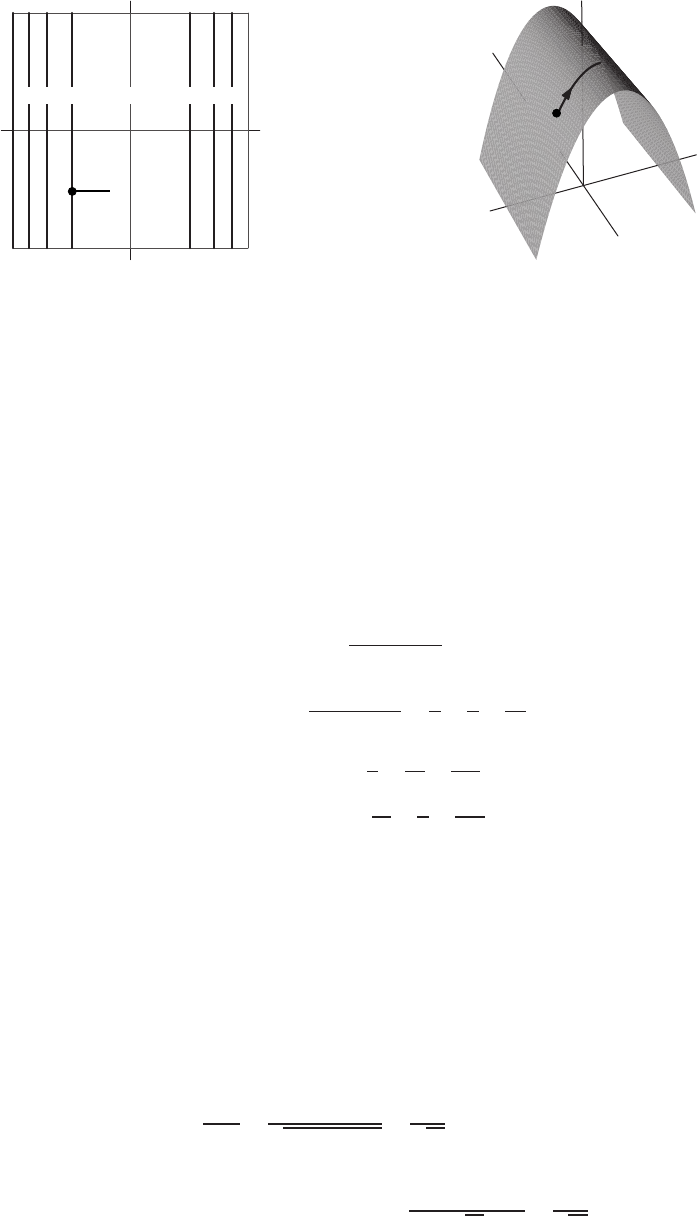
1314 Chapter Fourteen /SOLUTIONS
4321 3 2 1
x
y
✲
Figure 14.25
: Contour diagram for
z=g(x, y) = 4 −x2showing direction of
grad g(−1,−1)
x
y
z
Figure 14.26
: Graph of g(x, y) = 4 −x2
showing path of steepest ascent from the
point (−1,−1,3)
45. The gradient of (a) is 2x
~
i+ 2y~
j+ 2z~
k, which points radially outward from the origin, so (a) goes with (III).
The gradient of (c) is parallel to the gradient of (a) but pointing inward, so (c) goes with (IV).
The gradient of (b) is 2x
~
i+ 2y~
j, which points radially outward from the z-axis, so (b) goes with (I).
The gradient of (d) is parallel to the gradient of (b) but pointing inward, so (d) goes with (II).
46. (a) The surface is the level surface F(x, y, z) = 7, where F(x, y, z) = x2+y2−xyz. Thus the normal vector to the
tangent plane is grad F= (2x−yz)
~
i+ (2y−xz)~
j+ (−xy)~
k. Evaluated at (2,3,1), we get the normal to the
plane
~n =~
i+ 4~
j−6~
k .
Thus the equation of the plane is
(x−2) + 4(y−3) −6(z−1) = 0.
(b) Solving x2+y2−xyz = 7 for z, we get
z=x2+y2−7
xy .
Thus, we have
f(x, y) = x2+y2−7
xy =x
y+y
x−7
xy .
We have
fx(x, y) = 1
y−y
x2+7
x2y
fy(x, y) = −x
y2+1
x+7
xy2.
Thus fx(2,3) = 1/3−3/4 + 7/12 = 1/6and fy(2,3) = −2/9 + 1/2 + 7/18 = 2/3. Thus the equation of the
tangent plane is
z= 1 + (1/6)(x−2) + (2/3)(y−3).
This is the same as the answer to part (a) when that equation is solved for z.
47. At the point (1,2,1), we have
grad f(1,2,1) = 2 ·1
~
i+ 2 ·2~
j+ 2 ·1~
k= 2
~
i+ 4~
j+ 2~
k .
The normal to the plane pointing away from the origin is
~n =~
i+ 2~
j+ 3~
k .
Thus we find the rate of change of fin the direction of the unit vector
~u =~n
||~n || =~n
√12+ 22+ 32=1
√14 (
~
i+ 2~
j+ 3~
k).
The rate of change is given by the directional derivative
f~u = grad f·~u = 2
~
i+ 4~
j+ 4~
k·(
~
i+ 2~
j+ 3~
k)
√14 =22
√14 .
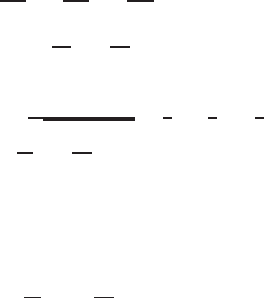
14.5 SOLUTIONS 1315
48. (a) To get a normal vector to the surface z= cos xsin yat the point (0, π/2,1), we first represent the surface Sby the
equation F(x, y, z) = z−cos xsin y= 0.Then we calculate the gradient of Fwhich is normal to S
grad F= sin xsin y~
i−cos xcos y~
j+~
k .
At the point (0, π/2,1),
grad F(0, π/2,1) = ~
k .
(b) The plane with normal ~
kand through the point (0, π/2,1) is
z= 1.
So z= 1 is the equation of the tangent plane at the point (0, π/2,1)
49. (a) Since f(x, y, z) = sin(x2+y2+z2), the level surfaces of fare spheres centered at the origin.
(b) Since fx= 2xsin(x2+y2+z2)and fy= 2ysin(x2+y2+z2)and fz= 2zsin(x2+y2+z2), we have
grad f= 2xsin(x2+y2+z2)
~
i+ 2ysin(x2+y2+z2)~
j+ 2zsin(x2+y2+z2)~
k .
(c) We can write the formula for grad fas
grad f= 2~r sin(x2+y2+z2),
so grad fis parallel to ~r at the point (x, y, z). Thus, the angle between grad fand ~r is 0◦or 180◦. The angle is 0◦
if sin(x2+y2+z2)is positive at that point and 180◦if sin(x2+y2+z2)is negative at that point. (We are assuming
that sin(x2+y2+z2)6= 0.)
50. (a) To do this you need to imagine the surfaces with the normal vector ~n at P.
For (I),
~n is (−,−,+)
or (+,+,−)
so (E)
For (II),
~n is (+,+,+)
or (−,−,−)
so (F)
For (III),
~n is (+,−,+)
or (−,+,−)
so (G)
For (IV),
~n is (−,+,+)
or (+,−,−)
so (H)
(b) Since the equation of the tangent plane is of the form
n1x+n2y+n3z=k,
the coefficients of x, y, z in the plane must have the same sign as the components of the normal. Hence (I)-(E)-(L);
(II)-(F)-(J); (III)-(G)-(M); (IV)-(H)-(K).
51. (a) A normal vector at (x, y, z)is given by
∇F(x, y, z) = ∂F
∂x~
i+∂F
∂y ~
j+∂F
∂z ~
k
= 2x
~
i−1
z2~
j+2y
z3~
k
The direction of maximum increase of Fis ∇F. At (0,0,1) this is −~
j, which is a unit vector. So ~u1=−~
j.
At (1,1,1) this is 2
~
i−~
j+ 2~
k, so the unit vector ~u2=2
~
i−~
j+2~
k
√22+(−1)2+22=2
3~
i−1
3~
j+2
3~
k .
(b) A normal vector at (0,0,1) is ∇f(0,0,1) = (2 ·0)
~
i−1
12~
j+2·0
13~
k=−~
j
The equation of the tangent plane at the point (0,0,1) is
((x−0)
~
i+ (y−0)~
j+ (z−1)~
k)·(−~
j) = 0,
i.e.,
−y= 0,so y= 0.
A normal vector at (1,1,1) is ∇f(1,1,1) = (2 ·1)
~
i−(1
12)~
j+ ( 2·1
13)~
k= 2
~
i−~
j+ 2~
k .
The equation of the tangent plane at (1,1,1) is
((x−1)
~
i+ (y−1)~
j+ (z−1)~
k)·(2
~
i−~
j+ 2~
k) = 0,
i.e.,
2x−2−y+ 1 + 2z−2 = 0,
so
2x−y+ 2z= 3.

1316 Chapter Fourteen /SOLUTIONS
(c) The vector ∇Fis parallel to the xy-plane when it is perpendicular to ~
k, i.e. when
(2x
~
i−1
z2~
j+2y
z3~
k)·~
k= 0,
that is, 2y
z3= 0 so y= 0.
Points that meet these requirements are those (x, y, z)such that
x2−y
z2= 0 and y= 0,
i.e., points such that x=y= 0 and z6= 0, that is, the z-axis minus the origin. (Observe that we must exclude the
points where z= 0 because the surface is not defined there: the expression x2−(y/z2)is undefined when z= 0.)
52. (a) The vector grad f(x, y)is perpendicular to the level curve of fthrough (x, y):
grad f(x, y) = (ex−1) cos y~
i−(ex−x) sin y~
j
Thus, at the point (2,3),
grad f(2,3) = (e2−1) cos 3
~
i−(e2−2) sin 3~
j
The vector grad fpoints in the direction of greatest increase in f, so the vector we want is
−grad f(2,3) = −(e2−1) cos 3
~
i+ (e2−2) sin 3~
j
= 6.33
~
i+ 0.76~
j
(b) To find a vector normal to the surface, we write the surface in the form
F(x, y, z) = (ex−x) cos y−z= 0.
Then
grad F= (ex−1) cos y~
i−(ex−x) sin y~
j−~
k .
So, at P,
grad F= (e2−1) cos 3
~
i−(e2−2) sin y~
j−~
k
=−6.33
~
i−0.76~
j−~
k .
The vector ~v is perpendicular to grad F, so
~v ·grad F= (5
~
i+ 4~
j+a~
k)·(−6.33
~
i−0.76~
j−~
k) = 0.
This gives
−5(6.33) −4(0.76) −a= 0
so
a=−34.69
53. (a) A normal to the surface is given by the gradient of the function f(x, y, z) = x2+y2+ 3z2,
grad f= 2x
~
i+ 2y~
j+ 6z~
k .
At the point (0.6,0.8,1), a normal to the surface and to the tangent plane is
~n = 1.2
~
i+ 1.6
~
i+ 6~
k .
Since the plane goes through the point (0.6,0.8,1), its equation is
1.2(x−0.6) + 1.6(y−0.8) + 6(z−1) = 0
1.2x+ 1.6y+ 6z= 8.

14.5 SOLUTIONS 1317
(b) We want to know if there are x, y, z values such that a normal to the surface is parallel to the normal to the plane.
That is, is 2x
~
i+ 2y~
j+ 6z~
kparallel to 8
~
i+ 6~
j+ 30~
k? Yes, if 2x= 8t, 2y= 6t, 6z= 30tfor some value
of t. That is, if
x= 4t, y = 3t, z = 5t.
Substituting these equations into the equation for the surface and solving for t, we get
(4t)2+ (3t)2+ 3 (5t)2= 4
100t2= 4
t=±r4
100 =±0.2.
So there are two points on the surface at which the tangent plane is parallel to the plane 8x+ 6y+ 30z= 1.They
are
±(0.8,0.6,1).
54. (a) The height is given by f(4,3) = 2(42)−(32) = 23. Your house is 23 units above the xy-plane.
(b) We want a directional derivative so we start by computing the gradient. Since the partial derivatives are fx= 4x
and fy=−2y, we have fx(4,3) = 16 and fy(4,3) = −6. The gradient vector is grad f= 16
~
i−6~
j. Letting
~v =−4
~
i−3~
j, we have k~v k= 5, so a unit vector in the same direction is ~u = (−4/5)
~
i−(3/5)~
j=−0.8
~
i−0.6~
j.
The directional derivative in the direction of ~u at the point (4,3) is
f~u (4,3) = grad f(4,3) ·~u
= (16
~
i−6~
j)·(−0.8
~
i−0.6~
j)
=−9.2.
The ground slopes down in that direction quite steeply, going down at a rate of 9.2 units for every one horizontal unit
moved.
(c) The water runs off in the direction of minimum slope, which is the direction of the negative of the gradient vector at
that point. We already saw that grad f(4,3) = 16
~
i−6~
j, so the water runs off in the direction of −16
~
i+ 6~
j.
(d) We can write the surface z= 2x2−y2as F(x, y, z) = 2x2−y2−z= 0. Then Fx= 4xand Fy=−2yand
Fz=−1. At the point (4,3,23), we have Fx(4,3,23) = 16 and Fy(4,3,23) = −6and Fz(4,3,23) = −1. The
equation of the tangent plane is
16(x−4) −6(y−3) −1(z−23) = 0
16x−6y−z= 23
55. (a) See Figure 14.27.
π
2π3π
22π
−2
−1
1
2
3
x
y
■ ■
✻
✒
2
1
0
−1
Figure 14.27
(b) The bug is walking parallel to the y-axis. Looking to the right or left, the bug sees higher contours — thus it is in a
valley.
(c) See Figure 14.27.
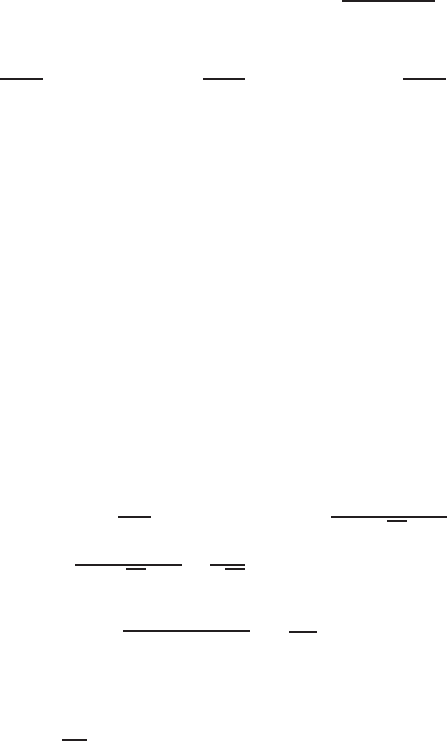
1318 Chapter Fourteen /SOLUTIONS
56. (a) The plane z= 5 is horizontal. The surface z= 1 + x2+y2is bowl-shaped, with its lowest point at (0,0,1). At this
point its tangent plane is horizontal and therefore parallel to the plane z= 5.
(b) The tangent plane to the surface z=f(x, y)at the point where (x, y) = (a, b)has equation
z=f(a, b) + fx(a, b)(x−a) + fy(a, b)(y−b).
Thus, for z= 1 + x2+y2, the tangent plane is
z= (1 + a2+b2) + 2a(x−a) + 2b(y−b)
= (1 −a2−b2) + 2ax + 2by.
This is parallel to z= 5 + 6x−10ywhen 6 = 2a, and −10 = 2bso a= 3,b=−5. Then z=f(3,−5) =
1 + 32+ (−5)2= 35, so the point on the surface whose tangent plane is parallel to z= 5 + 6x−10yis (3,−5,35).
57. (a) In the direction of grad F:
grad F(−1,1,1)
=(2x+ 2xz2)
~
i+ (4y3)~
j+ (2x2z)~
k(−1,1,1)
=−4
~
i+ 4~
j+ 2~
k .
(b) The rate of change in the direction of grad Fwith respect to distance =k∇Fk=√16 + 16 + 4 = 6. Now we want
rate of change with respect to time. If we move at 4units/sec:
Rate of change of Conc
Time =Rate of change of Conc
Dist ×Rate of change of Dist
Time
= 6 ×4 = 24mg/cm3/sec.
58. The tangent plane is given by
3(x−2) + 10(y−1) −5(z−7) = 0
so
3x+ 10y−5z+ 19 = 0.
59. Since f~u =∇f·~u , we see that f~u 1and f~
u4are both positive because the angles between ~u 1and ∇fand between ~u 4
and ∇fare both between 0 and π/2. In addition, f~u 1is larger because the angle between ~u 1and ∇fis smaller than the
angle between ~u 4and ~
f. Similarly, f~u 2and f~u 3are both negative, and f~u 3is more negative. Thus,
f~u 3< f~
u2<0< f~u 4< f~u 1
60. (a) We have ∇G= (2x−5y)
~
i+ (−5x+ 2yz)~
j+ (y2)~
k, so ∇G(1,2,3) = −8
~
i+ 7~
j+ 4~
k. The rate of change is
given by the directional derivative in the direction ~v :
Rate of change in density =∇G·~v
k~v k= (−8
~
i+ 7~
j+ 4~
k)·(2
~
i+~
j−4~
k)
√21
=−16 + 7 −16
√21 =−25
√21 ≈ −5.455.
(b) The direction of maximum rate of change is ∇G(1,2,3) = −8
~
i+ 7~
j+ 4~
k.
(c) The maximum rate of change is k∇G(1,2,3)k=p(−8)2+ 72+ 42=√129 ≈11.36.
61. (a) The function T(x, y, z) = constant where x2+y2+z2=constant. These surfaces are spheres centered at the origin.
(b) Calculating the partial derivative with respect to xgives
∂T
∂x =−2xe−(x2+y2+z2).
Similar calculations for the other variables shows that
grad T= (−2x
~
i−2y~
j−2z~
k)e−(x2+y2+z2).

14.5 SOLUTIONS 1319
(c) At the point (1,0,0)
grad T(1,0,0) = −2e−1
~
i .
Moving from the point (1,0,0) to (2,1,0), you move in the direction
(2 −1)
~
i+ (1 −0)~
j=~
i+~
j .
A unit vector in this direction is
~u =~
i+~
j
√2.
The directional derivative of T(x, y, z)in this direction at the point (1,0,0) is
T~u (1,0,0) = −2e−1
~
i·~
i+~
j
√2=−√2e−1.
Since you are moving at a speed of 3 units per second,
Rate of change of temperature =−√2e−1·3 = −3√2e−1degrees/second.
62. We have
∂P
∂x = 5e−0.1√x2+y2+z2(−0.1)(2x)1
2(x2+y2+z2)−1/2=−0.5e−0.1√x2+y2+z2x
px2+y2+z2,
and similarly
∂P
∂y =−0.5e−0.1√x2+y2+z2y
px2+y2+z2,and ∂P
∂z =−0.5e−0.1√x2+y2+z2z
px2+y2+z2.
Thus the gradient of Pat (0,0,1) is
grad P=∂P
∂x (x,y,z)=(0,0,1)
~
i+∂P
∂y (x,y,z)=(0,0,1)
~
j+∂P
∂z (x,y,z)=(0,0,1)
~
k=−0.5e−0.1~
k .
Let ~u be a unit vector in the direction of ~v , so
~u =~v
k~v k.
Then
Rate of change of pressure in atm/sec =(Directional derivative in direction ~u in atm/mi)(Speed of spacecraft in mi/sec)
=P~u k~v k= (grad P·~u )k~v k= grad P·~v
k~v kk~v k= grad P·~v
=−0.5e−0.1~
k·(
~
i−2.5~
k) = 0.5·2.5e−0.1= 1.131 atm/sec.
63. (a) is (V) since ~r +~a is a vector not a scalar.
(b) is (IV) since grad(~r ·~a ) = grad(a1x+a2y+a3z) = ~a .
(c) is (V) since ~r ×~a is a vector not a scalar.
64. We must calculate the gradient of ϕ.
grad ϕ(x, y, z) = grad GmM
k~r k
=GMm grad 1
px2+y2+z2
Now
∂
∂x 1
px2+y2+z2!=∂
∂x (x2+y2+z2)−1/2=−1
2(x2+y2+z2)−3/22x=−x
(x2+y2+z2)3/2.
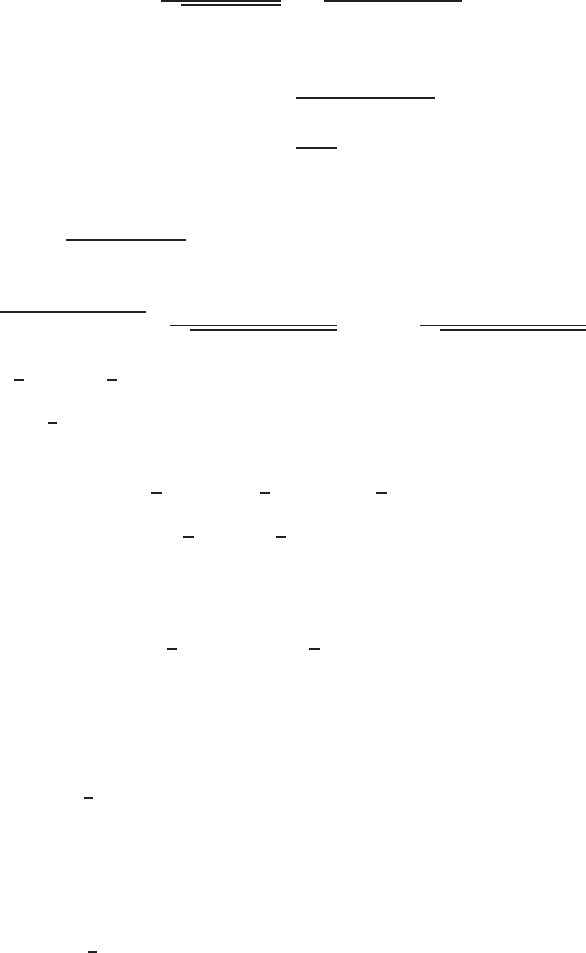
1320 Chapter Fourteen /SOLUTIONS
The partial derivatives with respect to yand zare similar, so
grad 1
px2+y2+z2=−x
~
i+y~
j+z~
k
(x2+y2+z2)3/2.
Thus,
grad ϕ=−GMm x
~
i+y~
j+z~
k
(x2+y2+z2)3/2
=−GMm ~r
k~r k3
=~
F
65. The tangent plane to z=p2x2+ 2y2−25 at (x, y) = (4,3) is
z=z(4,3) + zx(4,3)(x−4) + zy(4,3)(y−3)
=p2(4)2+ 2(3)2−25 + 2(4)
p2(4)2+ 2(3)2−25 (x−4) + 2(3)
p2(4)2+ 2(3)2−25 (y−3)
= 5 + 8
5(x−4) + 6
5(y−3).
The tangent plane to z=1
5(x2+y2)at (x, y) = (4,3) is
z=z(4,3) + zx(4,3)(x−4) + zy(4,3)(y−3)
=1
5(42+ 32) + 2
5(4)(x−4) + 2
5(3)(y−3)
= 5 + 8
5(x−4) + 6
5(y−3).
Thus the two surfaces are tangential at the point (4,3,5).
66. The points of intersection are (x, y) = (a, b)such that
1
2(a2+b2−1) = 1
2(1 −a2−b2)
a2+b2−1 = 1 −(a2+b2)
2(a2+b2) = 2
a2+b2= 1,
which are points on the unit circle.
The tangent plane to z=1
2(x2+y2−1) at (x, y) = (a, b)such that a2+b2= 1 is
z=z(a, b) + zx(a, b)(x−a) + zy(a, b)(y−b)
= 0 + a(x−a) + b(y−b)
=ax +by −(a2+b2)
=ax +by −1,or ax +by −z= 1.
Similarly, the tangent to z=1
2(1 −x2−y2)at (x, y) = (a, b)such that a2+b2= 1 is z=−ax −by + 1 or
ax +by +z= 1. The normal vector to the plane ax +by −z= 1 is ~n1=a
~
i+b~
j−~
kand the normal vector to the
plane ax +by +z= 1 is ~n2=a
~
i+b~
j+~
k.
Since ~n1·~n2=a2+b2−1 = 1 −1 = 0,~n1and ~n2are perpendicular, hence the two surfaces are orthogonal at
all points of intersection.
67.
grad(~µ ·~r ) = grad(µ1x+µ2y+µ3z)
=µ1
~
i+µ2~
j+µ3~
k=~µ .
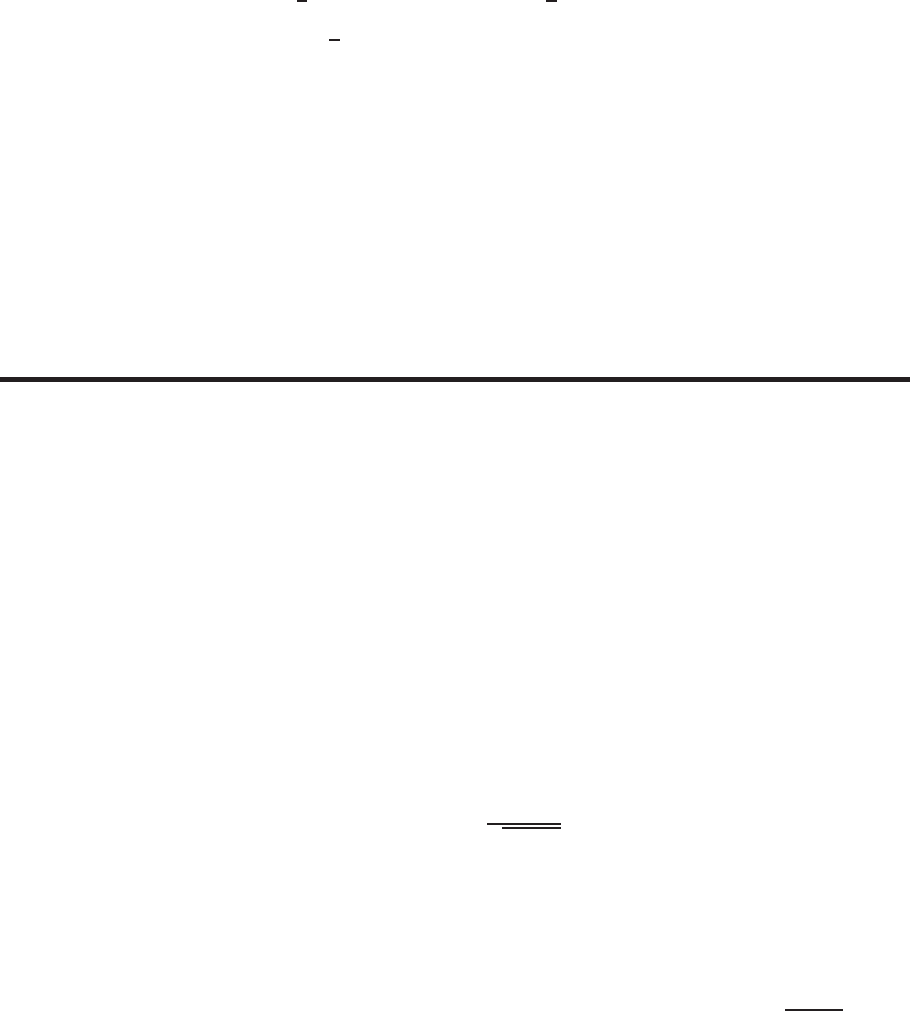
14.5 SOLUTIONS 1321
68.
grad(k~r ka) = grad((x2+y2+z2)a/2)
=a
2(x2+y2+z2)(a/2)−1(2x)
~
i+a
2(x2+y2+z2)(a/2)−1(2y)~
j
+a
2(x2+y2+z2)(a/2)−1(2z)~
k
=a(x2+y2+z2)(a−2)/2(x
~
i+y~
j+z~
k)
=ak~r ka−2~r .
69. If write ~r =x
~
i+y~
j+z~
k, then we know
grad f(x, y, z) = g(x, y, z)(x
~
i+y~
j+z~
k) = g(x, y, z)~r
so grad fis everywhere radially outward, and therefore perpendicular to a sphere centered at the origin. If fwere not
constant on such a sphere, then grad fwould have a component tangent to the sphere. Thus, fmust be constant on any
sphere centered at the origin.
Strengthen Your Understanding
70. The gradient vector grad f(x, y)points in the direction perpendicular to the level curves f(x, y) = Cin the xy-plane.
71. The correct equation of the tangent plane is
fx(0,0,0)x+fy(0,0,0)y+fz(0,0,0)z= 0.
72. The surface z=f(x, y)can be rewritten f(x, y)−z= 0 with normal at (0,0) given by
~n =fx(0,0)
~
i+fy(0,0)~
j−~
k .
To have normal vector ~n =~
i−2~
j−~
k, we take fx(0,0) = 1 and fy(0,0) = −2. One example is f(x, y) = x−2y.
73. Any function f(x, y, z) = 2x+ 3y+ 4z+Cwhere Cis a constant has grad f= 2
~
i+ 3~
j+ 4~
k . For example, we can
take
f(x, y, z) = 2x+ 3y+ 4z+ 100.
74. We have
grad f= 2
~
i−3~
j .
We want vectors ~u and ~v which are perpendicular to grad f. Two possibilities are ~
kand 3
~
i+ 2~
j. Creating unit vectors
gives
~u =~
kand ~v =1
√32+ 223
~
i+ 2~
j.
Then grad f·~u = grad f·~v = 0, so f~u =f~v = 0.
75. False. The equation z= 2 + 2x(x−1) + 3y2(y−1) is not linear. The correct equation is z= 2 + 2(x−1) + 3(y−1),
which is obtained by evaluating the partial derivatives at the point (1,1).
76. True. For example, the function f(x, y) = x2+y2has a horizontal tangent plane at (0,0).
77. This is never true, because, if θis the angle between grad fand the z-axis at any point, then f~
k=kgrad fkcos θ≤
kgrad fk.
78. Can be true, For example for f(x, y, z) = 4x−3z, we have grad f= 4
~
i−3~
kthen kgrad fk=√42+ 32= 5 and
f~
k=fz=−3.
79. (a) The units of ||grad f|| are ◦C per meter. It represents the rate of change of temperature with distance as you move in
the direction of grad f.
(b) The units of grad f·~v are ◦C per second. It represents the rate of change of temperature with time as you move with
velocity ~v .
(c) The units of ||grad f||·||~v || are ◦C per second. It represents the rate of change of temperature with time if you move
in the direction of grad fwith speed ||~v ||.
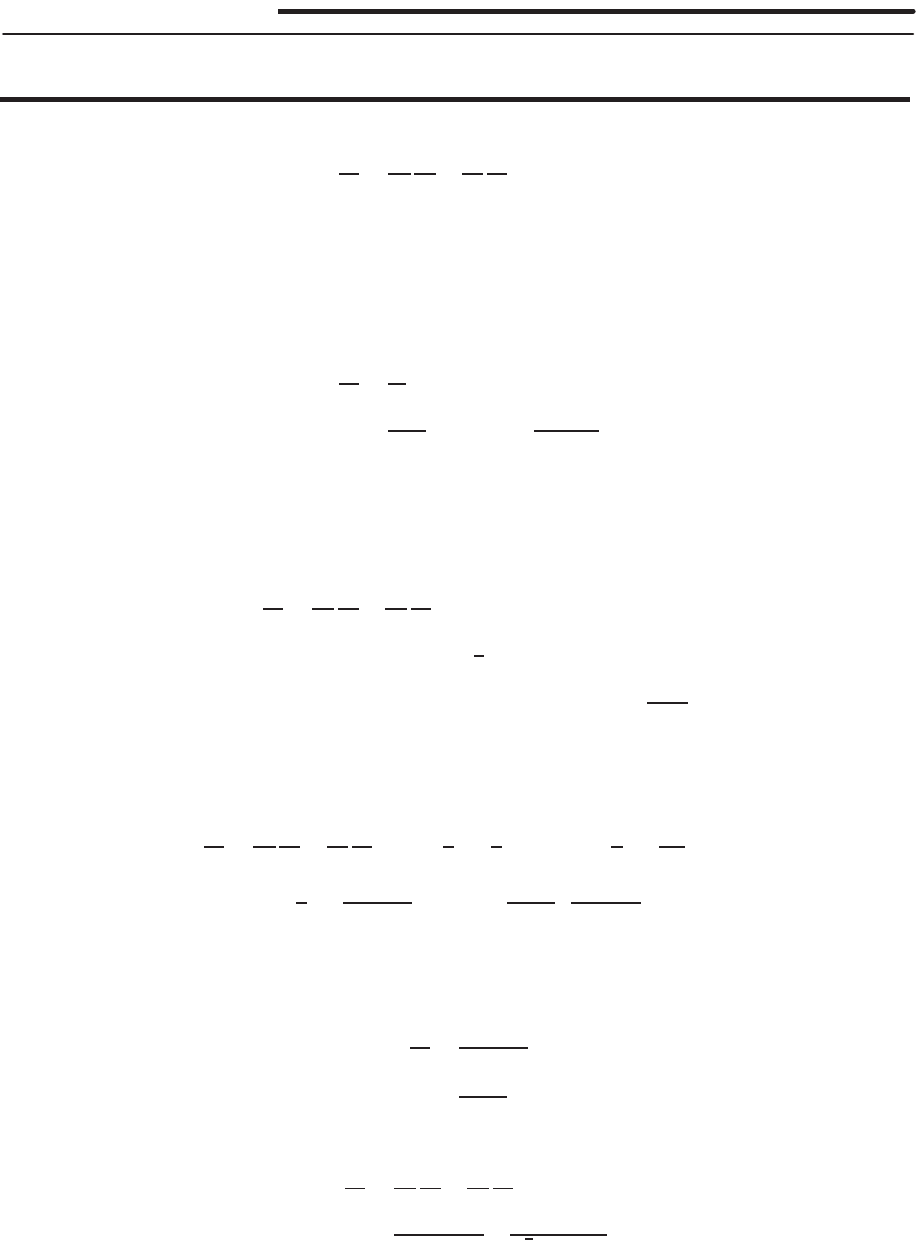
1322 Chapter Fourteen /SOLUTIONS
Solutions for Section 14.6
Exercises
1. Using the chain rule we see:
dz
dt =∂z
∂x
dx
dt +∂z
∂y
dy
dt
=−y2e−t+ 2xy cos t
=−(sin t)2e−t+ 2e−tsin tcos t
= sin(t)e−t(2 cos t−sin t)
We can also solve the problem using one variable methods:
z=e−t(sin t)2
dz
dt =d
dt (e−t(sin t)2)
=de−t
dt (sin t)2+e−td(sin t)2
dt
=−e−t(sin t)2+ 2e−tsin tcos t
=e−tsin t(2 cos t−sin t)
2. Using the chain rule we see:
dz
dt =∂z
∂x
dx
dt +∂z
∂y
dy
dt
= 2t(sin y+ycos x) + 1
t(xcos y+ sin x)
= 2tsin(ln t) + 2tln(t) cos(t2) + tcos(ln t) + sin t2
t
This problem can also be solved using one variable methods. Attempting to solve the problem that way will demonstrate
the advantage of using the chain rule.
3. Substituting into the chain rule gives
dz
dt =∂z
∂x
dx
dt +∂z
∂y
dy
dt = cos x
y1
y(2) + cos x
y−x
y2(−2t)
= cos x
y2y+ 2xt
y2= 2 cos 2t
1−t21 + t2
(1 −t2)2
4. This is a case where substituting is easier:
z= ln(t−2+t)
dz
dt =1−2t−3
t−2+t
=t3−2
t+t4
If you use the chain rule the solution is:
dz
dt =∂z
∂x
dx
dt +∂z
∂y
dy
dt
=−2x
t2(x2+y2)+y
√t(x2+y2)
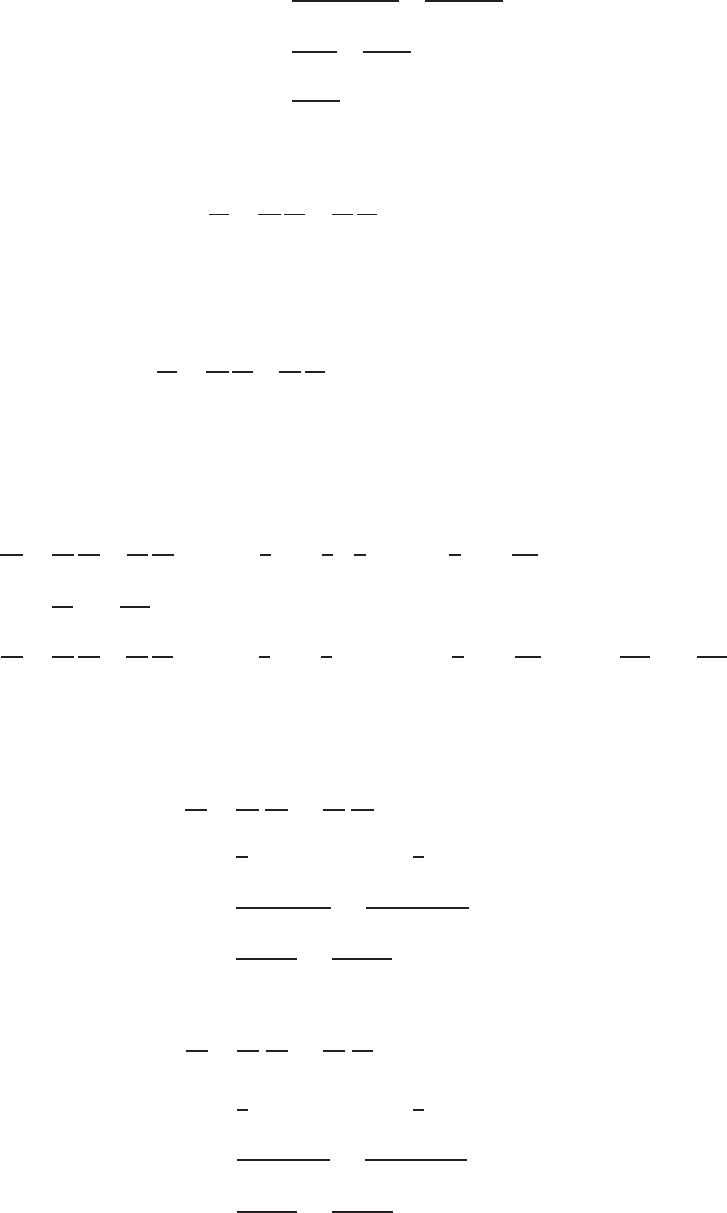
14.6 SOLUTIONS 1323
=−2
t3((1/t)2+t)+1
(1/t)2+t
=−2
t+t4+t2
1 + t3
=t3−2
t+t4
5. Substituting into the chain rule gives
dz
dt =∂z
∂x
dx
dt +∂z
∂y
dy
dt =ey(2) + xey(−2t)
= 2ey(1 −xt) = 2e1−t2(1 −2t2).
6. Substituting into the chain rule gives
dz
dt =∂z
∂x
dx
dt +∂z
∂y
dy
dt =ey(2) + (xey+ey+yey)(−2t)
= 2ey(1 −xt −t−yt) = 2e1−t2(1 −2t2−2t+t3).
7. Since zis a function of two variables xand ywhich are functions of two variables uand v, the two chain rule identities
which apply are:
∂z
∂u =∂z
∂x
∂x
∂u +∂z
∂y
∂y
∂u =cos x
y1
y1
u+cos x
y−x
y2·0
=1
vu cos ln u
v.
∂z
∂v =∂z
∂x
∂x
∂v +∂z
∂y
∂y
∂v =cos x
y1
y·0 + cos x
y−x
y2·1 = −ln u
v2cos ln u
v.
8. Since zis a function of two variables xand ywhich are functions of two variables uand v, the two chain rule identities
which apply are:
∂z
∂u =∂z
∂x
∂x
∂u +∂z
∂y
∂y
∂u
=1
x·2(u2+v2)(2u) + 1
y·2(u3+v3)(3u2)
=4u(u2+v2)
(u2+v2)2+6u2(u3+v3)
(u3+v3)2
=4u
u2+v2+6u2
u3+v3.
Similarly, we have
∂z
∂v =∂z
∂x
∂x
∂v +∂z
∂y
∂y
∂v
=1
x·2(u2+v2)(2v) + 1
y·2(u3+v3)(3v2)
=4v(u2+v2)
(u2+v2)2+6v2(u3+v3)
(u3+v3)2
=4v
u2+v2+6v2
u3+v3.
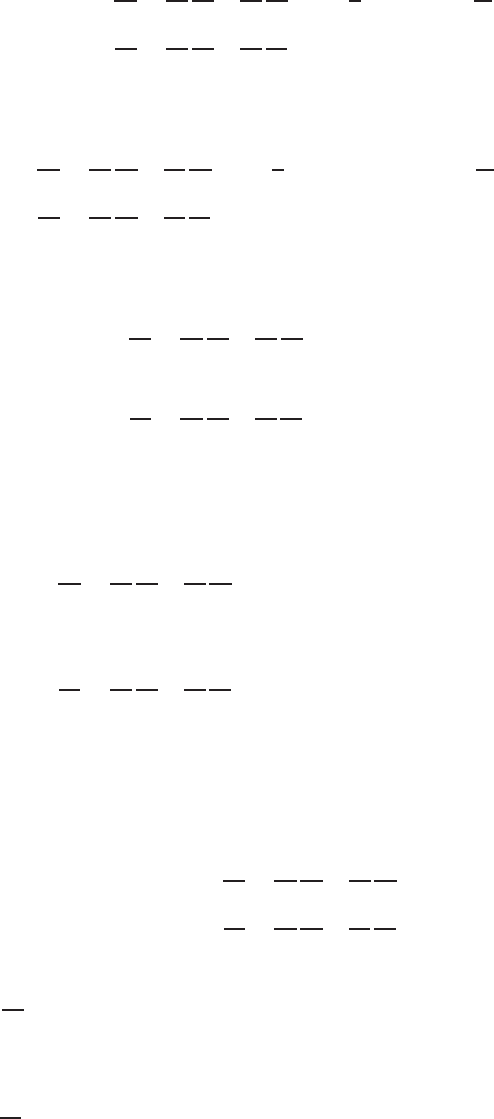
1324 Chapter Fourteen /SOLUTIONS
9. Since zis a function of two variables xand ywhich are functions of two variables uand v, the two chain rule identities
which apply are:
∂z
∂u =∂z
∂x
∂x
∂u +∂z
∂y
∂y
∂u =ey1
u+xey·0 = ev
u.
∂z
∂v =∂z
∂x
∂x
∂v +∂z
∂y
∂y
∂v =ey(0) + xey·1 = evln u.
10. Since zis a function of two variables xand ywhich are functions of two variables uand v, the two chain rule identities
which apply are:
∂z
∂u =∂z
∂x
∂x
∂u +∂z
∂y
∂y
∂u =ey1
u+ey(1 + x+y)·0 = ev
u.
∂z
∂v =∂z
∂x
∂x
∂v +∂z
∂y
∂y
∂v =ey(0) + ey(1 + x+y)·1 = (1 + ln u+v)ev.
11. Since zis a function of two variables xand ywhich are functions of two variables uand v, the two chain rule identities
which apply are:
∂z
∂u =∂z
∂x
∂x
∂u +∂z
∂y
∂y
∂u =ey(2u) + xey(2u)
= 2uey(1 + x) = 2ue(u2−v2)(1 + u2+v2).
∂z
∂v =∂z
∂x
∂x
∂v +∂z
∂y
∂y
∂v =ey(2v) + xey(−2v)
= 2vey(1 −x) = 2ve(u2−v2)(1 −u2−v2).
12. Since zis a function of two variables xand ywhich are functions of two variables uand v, the two chain rule identities
which apply are:
∂z
∂u =∂z
∂x
∂x
∂u +∂z
∂y
∂y
∂u =ey(2u) + (xey+ey+yey)(2u)
= 2uey(1 + x+ 1 + y) = 2uey(x+y+ 2)
= 2ue(u2−v2)(u2+v2+u2−v2+ 2) = 2ue(u2−v2)(2u2+ 2)
∂z
∂v =∂z
∂x
∂x
∂v +∂z
∂y
∂y
∂v =ey(2v) + (xey+ey+yey)(−2v)
= 2vey(1 −x−1−y) = −2vey(x+y)
=−2ve(u2−v2)(u2+v2+u2−v2) = −4u2ve(u2−v2).
13. Since zis a function of two variables xand ywhich are functions of two variables uand v, the two chain rule identities
which apply are:
∂z
∂u =∂z
∂x
∂x
∂u +∂z
∂y
∂y
∂u
∂z
∂v =∂z
∂x
∂x
∂v +∂z
∂y
∂y
∂v
First to find ∂z/∂u
∂z
∂u = (e−y−ye−x) sin v+ (−xe−y+e−x)(−vsin u)
= (e−vcos u−v(cos u)e−usin v) sin v−(−u(sin v)e−vcos u+e−usin v)vsin u
Now we find ∂z/∂v using the same method.
∂z
∂v = (e−y−ye−x)ucos v+ (−xe−y+e−x) cos u
= (e−vcos u−v(cos u)e−usin v)ucos v+ (−u(sin v)e−vcos u+e−usin v) cos u
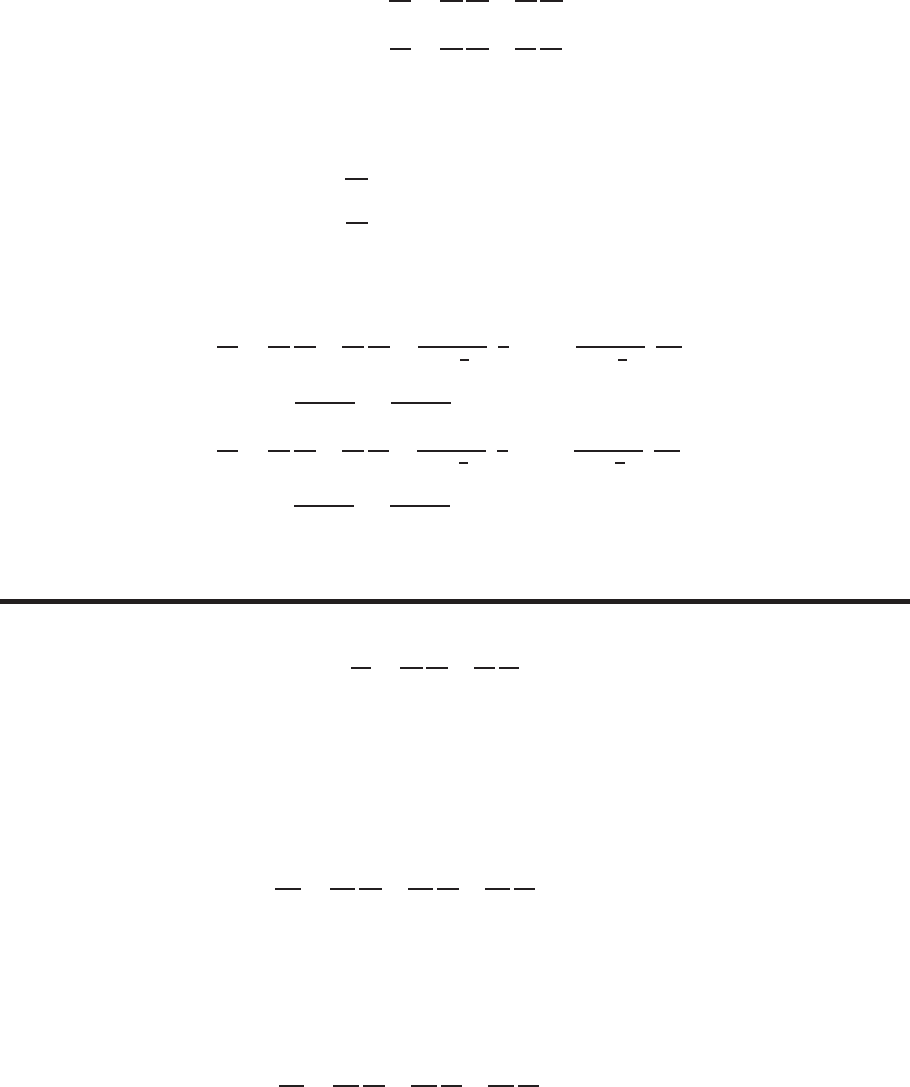
14.6 SOLUTIONS 1325
14. Since zis a function of two variables xand ywhich are functions of two variables uand v, the two chain rule identities
which apply are:
∂z
∂u =∂z
∂x
∂x
∂u +∂z
∂y
∂y
∂u
∂z
∂v =∂z
∂x
∂x
∂v +∂z
∂y
∂y
∂v
This problem is most easily solved by substitution:
z= cos(u2((cos v)2+ (sin v)2))
= cos u2
∂z
∂u =−2usin u2
∂z
∂v = 0
This problem can also be solved using the chain rule but it is more difficult.
15. Since zis a function of two variables xand ywhich are functions of two variables uand v, the two chain rule identities
which apply are:
∂z
∂v =∂z
∂x
∂x
∂u +∂z
∂y
∂y
∂u =1
1 + ( x
y)2(1
y)(2u) + 1
1 + ( x
y)2(−x
y2)(2u)
= 2u(y−x
y2+x2) = −2uv2
u4+v4
∂z
∂v =∂z
∂x
∂x
∂v +∂z
∂y
∂y
∂v =1
1 + ( x
y)2(1
y)(2v) + 1
1 + ( x
y)2(−x
y2)(−2v)
= 2v(y+x
y2+x2) = 2vu2
u4+v4.
Problems
16. By the chain rule
dz
dt =∂z
∂x
dx
dt +∂z
∂y
dy
dt
= (3x2y2)(3t2) + (2x3y)(2t)
= (3t6t4)3t2+ (2t9t2)2t
= 9t12 + 4t12
= 13t12
Directly, we have z=t9·t4=t13,so dz/dt = 13t12.
17. Using the chain rule we have
∂w
∂ρ =∂w
∂x
∂x
∂ρ +∂w
∂y
∂y
∂ρ +∂w
∂z
∂z
∂ρ
= (2x) sin φcos θ+ (2y) sin φsin θ−(2z) cos φ
= 2ρsin2φcos2θ+ 2ρsin2φsin2θ−2ρcos2φ,
= 2ρsin2φ(cos2θ+ sin2θ)−2ρcos2φ
= 2ρsin2φ−2ρcos2φ
=−2ρcos 2φ.
∂w
∂θ =∂w
∂x
∂x
∂θ +∂w
∂y
∂y
∂θ +∂w
∂z
∂z
∂θ
= (2x)(−ρsin φsin θ) + (2y)ρsin φcos θ
=−2ρ2sin2φcos θsin θ+ 2ρ2sin2φsin θcos θ
= 0
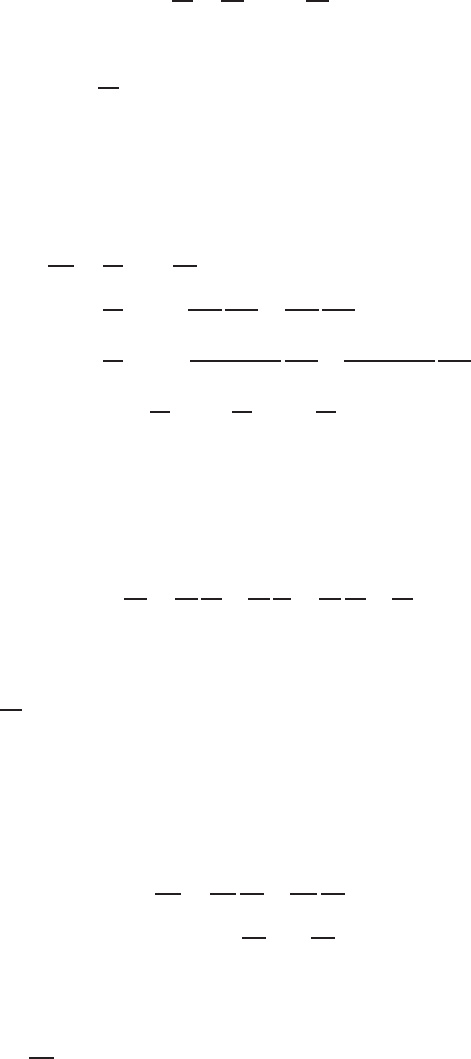
1326 Chapter Fourteen /SOLUTIONS
18. (a) ∂f/∂t
(b) (∂f /∂x)(dx/dt)
(c) (∂f/∂y)(dy/dt)
19. When t= 1,
x=g(1) = 3 and y=h(1) = 10,
so z=f(3,10) = 7. Thus
∂z
∂t =∂f
∂x g′(t) + ∂f
∂y h′(t)
gives
∂z
∂t t=1
=fx(3,10) ·g′(1) + fy(3,10) ·h′(1)
= 100 ·4 + 0.1·11
= 400 + 1.1 = 401.1.
20. The voltage at any time tis given by V=IR where Ris the resistance for the whole circuit. (In this case R=
R1R2/(R1+R2).) So the rate at which the voltage is changing is
dV
dt =dI
dt R+IdR
dt
=dI
dt R+I∂R
∂R1
dR1
dt +∂R
∂R2
dR2
dt
=dI
dt R+IR2
2
(R1+R2)2
dR1
dt +R2
1
(R1+R2)2
dR2
dt
= 0.01 15
8+ 2 25
64 (0.5) + 9
64 (−0.1)
= 0.3812.
So the voltage is increasing by 0.3812 volts/sec.
21. Let p(x, t)be the air pressure in pascals at xkm east of the island at time thours after the ship passes the island. We want
to compute ∂p/∂t.
Let S(t)be the air pressure on the ship at time t, so that S(t) = p(10t, t). By the chain rule we have
dS
dt =∂p
∂x
dx
dt +∂p
∂t
dt
dt =∂p
∂x
dx
dt +∂p
∂t
Since dS/dt = (−50 pascal)/(2 hour) = −25 pascal/hour, and ∂p/∂x =−2pascal/km, and dx/dt = 10 km/hour,
solving for ∂p/∂t, we have
∂p
∂t =−25 pascal/hour −(−2pascal/km)(10 km/hour) = −5pascal/hour
22. Let the square cross section have side length x(T)and the bar have length L(T)at temperature T◦C; then
Volume of the bar =V=x2L.
Using the chain rule we have:
dV
dT =∂V
∂x
dx
dT +∂V
∂L
dL
dT
= 2xL dx
dT +x2dL
dT
= (2xL +x2)·13 ·10−6,
since dx/dT =dL/dT = 13 ·10−6.When L= 3 and x= 0.05, the rate of increase of volume is
dV
dT = (2 ·(0.05) ·3 + 0.052)·13 ×10−6= 3.93 ·10−6m3/◦C.

14.6 SOLUTIONS 1327
23.
2020 2040
13
14
15
t
(years)
R(
in
)
✻
❄
2
✲✛ 30
Figure 14.28
: Global warming predictions:
Rainfall as a function of time
2020 2040
23
25
27
t
(years)
T(◦
C
)
✲✛ 40
✻
❄
3
Figure 14.29
: Global warming predictions:
Temperature as a function of time
We know that, as long as the temperature and rainfall stay close to their current values of R= 15 inches and
T= 30◦C, a change, ∆R, in rainfall and a change, ∆T, in temperature produces a change, ∆C, in corn production given
by
∆C≈3.3∆R−5∆T.
Now both Rand Tare functions of time t(in years), and we want to find the effect of a small change in time, ∆t, on R
and T. Figure 14.28 shows that the slope of the graph for Rversus tis about −2/30 ≈ −0.07 in/year when t= 2020.
Similarly, Figure 14.29 shows the slope of the graph of Tversus tis about 3/40 ≈0.08◦C/year when t= 2020. Thus,
around the year 2020,
∆R≈ −0.07∆tand ∆T≈0.08∆t.
Substituting these into the equation for ∆C, we get
∆C≈(3.3)(−0.07)∆t−(5)(0.08)∆t≈ −0.6∆t.
Since at present C= 100, corn production will decline by about 0.6 % between the years 2020 and 2021. Now ∆C≈
−0.6∆ttells us that when t= 2020,
∆C
∆t≈ −0.6,and therefore, that dC
dt ≈ −0.6.
24. (a) The level surfaces of fare concentric spheres centered at the origin. This is because if f(x, y, z)is fixed, then g(ρ)
is fixed, which means ρmust be fixed. Fixed ρgives a sphere.
(b) By the chain rule, we find
∂f
∂x =dg
dρ
∂ρ
∂x =g′(ρ)1
2(x2+y2+z2)−1/2·2x=g′(ρ)x
px2+y2+z2.
Thus
~
F= grad f=dg
dρ ·x
~
i+y~
j+z~
k
ρ,
so ~
F(x, y, z)is parallel to x
~
i+y~
j+z~
k. A unit vector in the direction of ~
Fat (1,2,2) is
~u =~
i+ 2~
j+ 2~
k
√12+ 22+ 22=1
3~
i+2
3~
j+2
3~
k .
(c) We have
||~
F|| =
dg
dρ ·
x
~
i+y~
j+z~
k
ρ=
dg
dρ .
Since ρ=√12+ 22+ 22= 3 at (1,2,3), we estimate g′(3) from the graph, obtaining g′(ρ(1,2,2)) = g′(3) ≈
1/3. Thus
||~
F(1,2,2)|| ≈ 1
3.
(d) From the answers to parts (b) and (c), we know that ~
F(1,2,2) is a vector of length about 1/3in the direction of
~
i+ 2~
j+ 2~
k. Thus, we estimate
~
F(1,2,2) ≈1
9(
~
i+ 2~
j+ 2~
k).

1328 Chapter Fourteen /SOLUTIONS
(e) We estimate ~
F(3,0,0) ≈1
3~
i, because ||~
F(3,0,0)|| =g′(ρ(3,0,0)) = g′(3) ≈1/3, and the direction of
~
F(x, y, z)is parallel to x
~
i+y~
j+z~
k= 3
~
i.
(f) (i) We have ||~
F(P)|| =||~
F(Q)|| because ||~
F(P)|| =|g′(ρ(P))|=|g′(ρ(Q))|=||~
F(Q)||.
(ii) At each point, ~
F(~r )points in the same direction as ~r , where x
~
i+y~
j+z~
k.
25. By the chain rule,
∂z
∂t =guut+gvvt+gwwt.
Thus, there are three terms.
26.
∂w
∂x
∂w
∂y ∂w
∂z
w
x y z
u v
∂x
∂u
∂x
∂v
∂y
∂u
∂y
∂v
∂z
∂u
∂z
∂v
Figure 14.30
The tree diagram in Figure 14.30 tells us that
∂w
∂u =∂w
∂x
∂x
∂u +∂w
∂y
∂y
∂u +∂w
∂z
∂z
∂u ,
∂w
∂v =∂w
∂x
∂x
∂v +∂w
∂y
∂y
∂v +∂w
∂z
∂z
∂v .
27.
w
x y z
t
∂w
∂x
∂w
∂y ∂w
∂z
dx
dt
dy
dt
dz
dt
Figure 14.31
From the tree diagram in Figure 14.31, we get
dw
dt =∂w
∂x
dx
dt +∂w
∂y
dy
dt +∂w
∂z
dz
dt .

14.6 SOLUTIONS 1329
28. All are done using the chain rule.
(a) We have u=x,v= 3. Thus du/dx = 1 and dv/dx = 0 so
f′(x) = Fu(x, 3)(1) + Fv(x, 3)(0) = Fu(x, 3).
(b) We have u= 3,v=x. Thus du/dx = 0 and dv/dx = 1 so
f′(x) = Fu(3, x)(0) + Fv(3, x)(1) = Fv(3, x).
(c) We have u=x,v=x. Thus du/dx =dv/dx = 1 so
f′(x) = Fu(x, x)(1) + Fv(x, x)(1) = Fu(x, x) + Fv(x, x).
(d) We have u= 5x,v=x2. Thus du/dx = 5 and dv/dx = 2xso
f′(x) = Fu(5x, x2)(5) + Fv(5x, x2)(2x).
29. Using the chain rule,
zu(u, v) = fx(x, y)·xu(u, v) + fy(x, y)·yu(u, v).
Since x(1,2) = 5 and y(1,2) = 3, substituting gives
zu(1,2) = fx(5,3) ·xu(1,2) + fy(5,3) ·yu(1,2) = b·e+d·p.
30. Using the chain rule,
zv(u, v) = fx(x, y)·xv(u, v) + fy(x, y)·yv(u, v).
Since x(1,2) = 5 and y(1,2) = 3, substituting gives
zv(1,2) = fx(5,3) ·xv(1,2) + fy(5,3) ·yv(1,2) = b·k+d·q.
31. Implicit differentiation with respect to xof the equation f(x, y) = f(a, b)gives fx(x, y)dx/dx +fy(x, y)dy/dx = 0.
Thus fy(x, y)dy/dx =−fx(x, y). If fy(a, b)6= 0 we can solve for the slope of the level curve at the point (a, b):
dy/dx =−fx(a, b)/fy(a, b).
32. We have z=h(x, y)where h(x, y) = f(x)g(y),x=t, and y=t. The chain rule gives dz/dt = (∂h/∂x)dx/dt +
(∂h/∂y)dy/dt =∂h/∂x+∂h/∂y. Since ∂h/∂x =f′(x)g(y)and ∂h/∂y =f(x)g′(y)we have dz/dt =f′(x)g(y)+
f(x)g′(y) = f′(t)g(t) + f(t)g′(t).
33. Let g(t) = f(tx, ty). We use the chain rule, with u=tx and v=ty as our variables. Then we have
g′(t) = ∂f(u, v)
∂u
du
dt +∂f(u, v)
∂v
dv
dt
=fu(u, v)x+fv(u, v)y.
At t= 1, we have u=xand v=y. So
g′(1) = x fx(x, y) + y fy(x, y).
On the other hand, since f(x, y)is homogeneous of degree pwe also have g(t) = tpf(x, y). Thus we have
g′(t) = p tp−1f(x, y)
and
g′(1) = p f(x, y).
Thus,
x fx(x, y) + y fy(x, y) = p f(x, y).
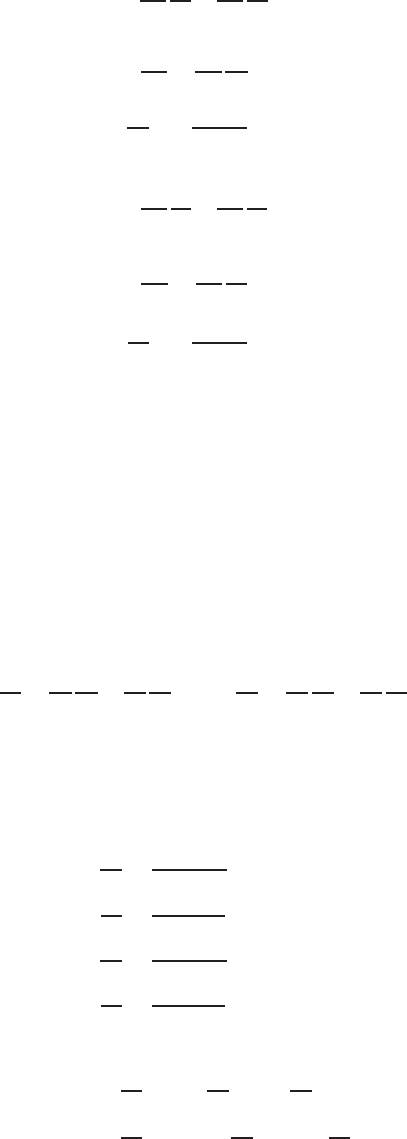
1330 Chapter Fourteen /SOLUTIONS
34. Use chain rule for the equation 0 = F(x, y, f(x, y)). Differentiating both sides with respect to x, remembering z=
f(x, y)and regarding yas a constant gives:
0 = ∂F
∂x
dx
dx +∂F
∂z
dz
dx .
Since dx/dx = 1, we get
−∂F
∂x =∂F
∂z
∂z
∂x ,
so ∂z
∂x =−∂F/∂x
∂F/∂z .
Similarly, differentiating both sides of the equation 0 = F(x, y, f(x, y)) with respect to ygives:
0 = ∂F
∂y
dy
dy +∂F
∂z
dz
dy .
Since dy/dy = 1, we get
−∂F
∂y =∂F
∂z
∂z
∂y ,
so ∂z
∂y =−∂F/∂y
∂F/∂z .
35. Using the chain rule,
zu(u, v) = fx(x, y)·xu(u, v) + fy(x, y)·yu(u, v).
Since x(4,5) = 2 and y(4,5) = 3, substituting gives
zu(4,5) = fx(2,3) ·xu(4,5) + fy(2,3) ·yu(4,5) = b·e+d·p.
36. Using the chain rule,
zv(u, v) = fx(x, y)·xv(u, v) + fy(x, y)·yv(u, v).
Since x(4,5) = 2 and y(4,5) = 3, substituting gives
zv(4,5) = fx(2,3) ·xv(4,5) + fy(2,3) ·yv(4,5) = b·k+d·q.
37. (a) We will use the chain rule identities,
∂z
∂r =∂z
∂x
∂x
∂r +∂z
∂y
∂y
∂r and ∂z
∂θ =∂z
∂x
∂x
∂θ +∂z
∂y
∂y
∂θ .
These equations are to be in terms of ∂z/∂x and ∂z/∂y, so we may calculate the other terms, switching from
Cartesian to polar coordinates. Recall polar coordinates :
x=rcos θ, y =rsin θ
Thus we have
∂x
∂r =∂(rcos θ)
∂r = cos θ
∂y
∂r =∂(rsin θ)
∂r = sin θ
∂x
∂θ =∂(rcos θ)
∂θ =−rsin θ
∂y
∂θ =∂(rsin θ)
∂θ =rcos θ
Now, substituting into the equations for ∂z/∂r and ∂z/∂θ, we get
(1) ∂z
∂r = cos θ∂z
∂x + sin θ∂z
∂y
(2) ∂z
∂θ =−rsin θ∂z
∂x +rcos θ∂z
∂y .
We will call these equations (1) and (2).
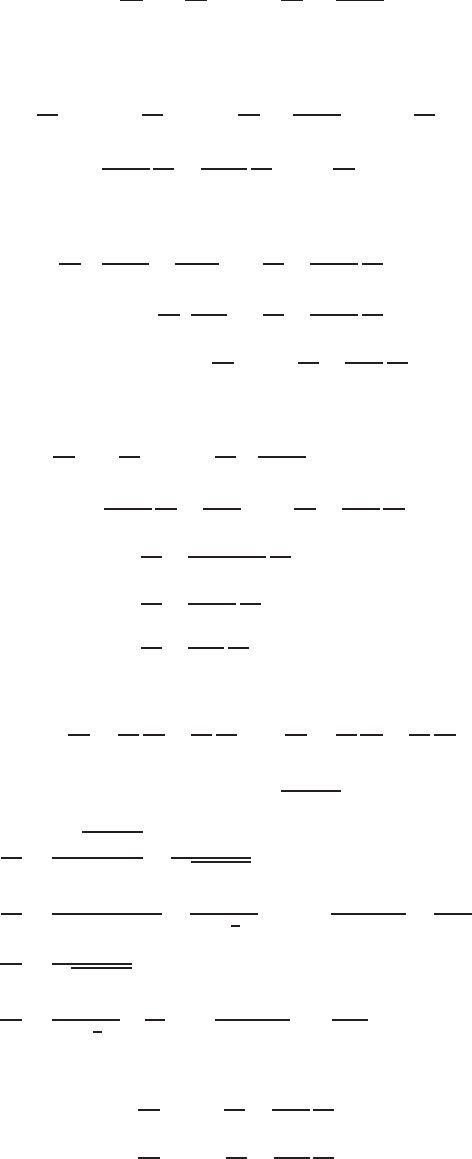
14.6 SOLUTIONS 1331
(b) Now we solve for ∂z/∂x and ∂z/∂y. From (2) we get:
(3) ∂z
∂x =∂z
∂θ −rcos θ∂z
∂y −1
rsin θ,
Now substitute (3) into (1):
∂z
∂r = cos θ∂z
∂θ −rcos θ∂z
∂y −1
rsin θ+ sin θ∂z
∂y
=−cos θ
rsin θ
∂z
∂θ +cos2θ
sin θ
∂z
∂y + sin θ∂z
∂y
Now solve for ∂z/∂y:
∂z
∂y cos2θ
sin θ+sin2θ
sin θ=∂z
∂r +cos θ
rsin θ
∂z
∂θ
∂z
∂y (1
sin θ) = ∂z
∂r +cos θ
rsin θ
∂z
∂θ
∂z
∂y = sin θ∂z
∂r +cos θ
r
∂z
∂θ .
Now, substitute ∂z/∂y into equation (3) and solve for ∂z/∂x.
∂z
∂x =∂z
∂θ −rcos θ∂z
∂y −1
rsin θ
=−1
rsin θ
∂z
∂θ +cos θ
sin θsin θ∂z
∂r +cos θ
r
∂z
∂θ
= cos θ∂z
∂r +cos2θ−1
rsin θ
∂z
∂θ
= cos θ∂z
∂r −sin2θ
rsin θ
∂z
∂θ
= cos θ∂z
∂r −sin θ
r
∂z
∂θ .
(c) Now we use the chain rule to get ∂z/∂x and ∂z/∂y.
(4) ∂z
∂y =∂z
∂r
∂r
∂y +∂z
∂θ
∂θ
∂y ,∂z
∂x =∂z
∂r
∂r
∂x +∂z
∂θ
∂θ
∂x
We will call this equation (4).
As before, we will calculate some of these partials using r=px2+y2and θ= arctan(y/x)
∂r
∂y =∂px2+y2
∂y =y
px2+y2= sin θ
∂θ
∂y =∂arctan(y/x)
∂y =1
1 + ( y
x)2(x−1) = x
(x2+y2)=cos θ
r
∂r
∂x =x
px2+y2= cos θ
∂θ
∂x =1
1 + ( y
x)2(−y
x2) = −y
(x2+y2)=−sin θ
r
Now, substituting these into (4), we get:
∂z
∂y = sin θ∂z
∂r +cos θ
r
∂z
∂θ
∂z
∂x = cos θ∂z
∂r −sin θ
r
∂z
∂θ
Note that these equations match with those found in part (b).
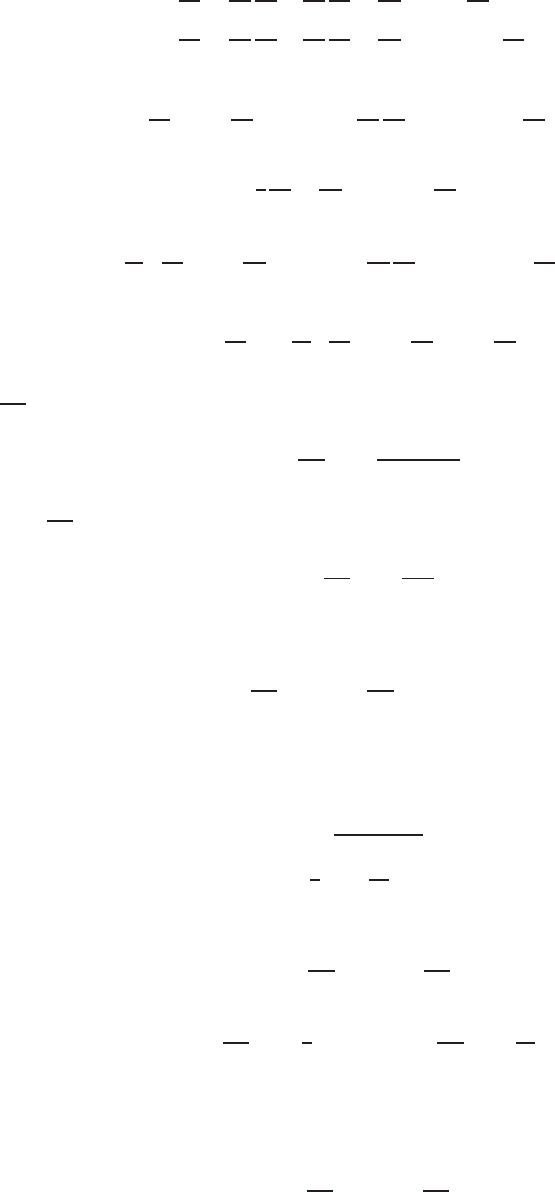
1332 Chapter Fourteen /SOLUTIONS
38. Using x=rcos θand y=rsin θwe compute ∂z/∂r and ∂z/∂θ in terms of ∂z/∂x and ∂z/∂y:
∂z
∂r =∂z
∂x
∂x
∂r +∂z
∂y
∂y
∂r =∂z
∂x cos θ+∂z
∂y sin θ
∂z
∂θ =∂z
∂x
∂x
∂θ +∂z
∂y
∂y
∂θ =∂z
∂x (−rsin θ) + ∂z
∂y rcos θ
So we have
∂z
∂r 2
=∂z
∂x 2
cos2θ+ 2 ∂z
∂x
∂z
∂y cos θsin θ+∂z
∂y 2
sin2θ
In addition we have, 1
r
∂z
∂θ =∂z
∂x (−sin θ) + ∂z
∂y cos θ
thus,
1
r2∂z
∂θ 2
=∂z
∂x 2
sin2θ−2∂z
∂x
∂z
∂y sin θcos θ+∂z
∂y 2
cos2θ
Adding we get
∂z
∂r 2
+1
r2∂z
∂θ 2
=∂z
∂x 2
+∂z
∂y 2
39. Since ∂U
∂P V
involves the variables Pand V, we are viewing Uas a function of these two variables, so U=U3(P, V ).
Then ∂U
∂P V
=∂U3(P, V )
∂P .
40. To calculate ∂U
∂P T
, we think of Uas a function of Pand T, as in U1(T, P ). Thus
∂U
∂P T
=∂U1
∂P .
41. From the example, we know that for this gas
dU =∂U
∂P V
dP +∂U
∂V P
dV = 7dP + 8dV.
In addition, we have
P dV +V dP = 3dV + 4dP = 2dT.
We substitute for dP = (2dT −3dV )/4into the expression for dU, giving
dU = 7 2dT−3dV
4+ 8dV
dU =7
2dT +11
4dV.
Comparing with the formula for dU obtained from the function U2, where U=U2(T, V ):
dU =∂U
∂T V
dT +∂U
∂V T
dV,
we have ∂U
∂T V
=7
2and ∂U
∂V T
=11
4.
42. The partial derivative on the left side of the equation is obtained by thinking of Tas a function of Vand P. The partial
derivative on the right side is obtained by thinking of Vas a function of Tand P.
Thinking of Tas a function of Vand P, we have
dT =∂T
∂V P
dV +∂T
∂P V
dP.
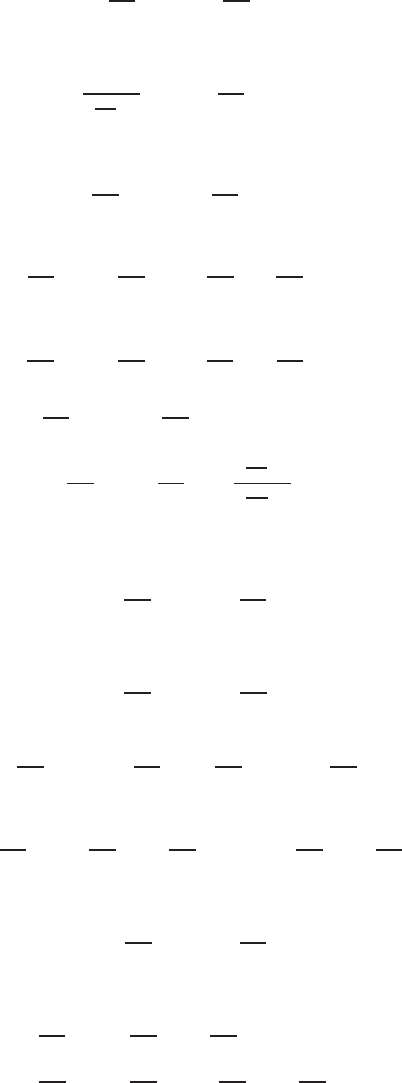
14.6 SOLUTIONS 1333
Thinking of Vas a function of Tand P. we also have
dV =∂V
∂T P
dT +∂V
∂P T
dP.
Solving for dT in terms of dV and dP gives
dT =1
∂V
∂T PdV −∂V
∂P P
dP .
Comparing coefficients of dV in the two expressions for dT gives
∂T
∂V P
= 1.∂V
∂T P
.
43. From Example 7, we know that ∂U
∂T P
=∂U
∂T V
+∂U
∂V T∂V
∂T P
.
Interchanging the roles of Tand V, we get
∂U
∂V P
=∂U
∂V T
+∂U
∂T V∂T
∂V P
.
Using the result of Problem 42, namely ∂T
∂V P
= 1.∂V
∂T P
, gives
∂U
∂V P
=∂U
∂V T
+∂U
∂T V
∂V
∂T P
.
44. (a) Thinking of Vas a function of Pand Tgives
dV =∂V
∂P T
dP +∂V
∂T P
dT.
(b) Substituting for dV in the following expression for dU,
dU =∂U
∂P V
dP +∂U
∂V P
dV,
we get
dU =∂U
∂P V
dP +∂U
∂V P∂V
∂P T
dP +∂V
∂T P
dT .
Rearranging terms gives
dU =∂U
∂P V
+∂U
∂V P·∂V
∂P TdP +∂U
∂V P·∂V
∂T P
dT.
(c) The formula for dU obtained by thinking of Uas a function of Pand Tis
dU =∂U
∂T P
dT +∂U
∂P T
dP.
(d) Comparing coefficients of dP and dT in the two formulas gives
∂U
∂T P
=∂U
∂V P·∂V
∂T P
∂U
∂P T
=∂U
∂P V
+∂U
∂V P·∂V
∂P T
.
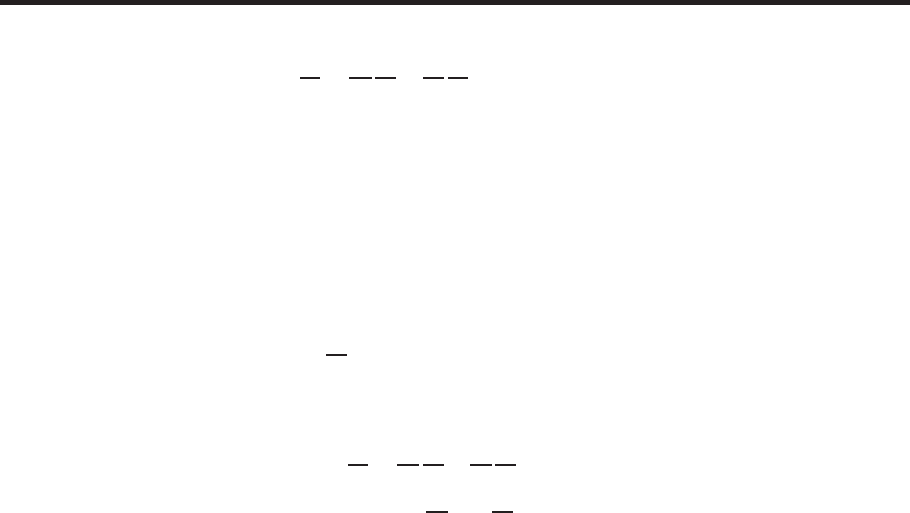
1334 Chapter Fourteen /SOLUTIONS
45. As the introduction to this problem indicates, we can differentiate with respect to xinside the integral:
f′(x) = Zb
0
Fu(x, y)dy.
46. By the Fundamental Theorem of Calculus, we substitute y=xin the integrand:
f′(x) = F(b, x).
47. (a) By Problem 45, treating was the constant b:
Gu(u, w) = Zw
0
Fu(u, y)dy.
By Problem 46, treating uas the constant b:
Gw(u, w) = F(u, w).
(b) To differentiate f(x) = G(x, x), we apply the chain rule to G(u, w)with u=x,w=x. Since ∂u/∂x =∂w/∂x =
1, we get
f′(x) = Gu(x, x)(1) + Gw(x, x)(1).
By part (a),
f′(x) = Zx
0
Fx(x, y)dy +F(x, x).
Strengthen Your Understanding
48. Writing z=f(x, y), with x=g(t)and y=h(t), the chain rule gives
dz
dt =∂z
∂x
dx
dt +∂z
∂y
dy
dt
=fx(g(t), h(t))g′(t) + fy(g(t), h(t))h′(t).
49. According to the chain rule, we evaluate Cx,Rxand Txat points (x, y)and we evaluate CRand TRat points (R, T ).
Since we know R(0,2) = 5 and T(0,2) = 1, the chain rule gives:
Cx(0,2) = CR(5,1)Rx(0,2) + CT(5,1)Tx(0,2).
50. The partial derivatives fxand fyshould be evaluated at (2,3):
∂z
∂t t=0
=fx(2,3)g′(0) + fy(2,3)h′(0).
51. We have
dz
dt =∂z
∂x
dx
dt +∂z
∂y
dy
dt
= 2xy dx
dt +x2dy
dt
= 2g(t)h(t)g′(t) + g(t)2h′(t).
If h(0) = 0,h′(0) = 1, and g(0) = 3, then (dz/dt)|t=0 = 9. For example, we can take h(t) = tand g(t) = 3 + t.

14.7 SOLUTIONS 1335
52. We have
dz
dt =∂z
∂x
dx
dt +∂z
∂y
dy
dt
=fx(x, y)2e2t+fy(x, y) cos t
dz
dt |t=0 =fx(1,0) ·2 + fy(1,0) ·1 = 2fx(1,0) + fy(1,0).
If fx(1,0) = 4 and fy(1,0) = 2, then dz/dt|t=0 = 10. For example, we can take f(x, y) = 4x+ 2y.
53. A possible answer is z=x+y,x=etand y=t2.
54. A possible answer is w=uv,u= 2s2+tand v=est.
55. A possible answer is z=x+y,x=tand y=t.
56. By the chain rule,
dz
dt =guuxx′+guuyy′+guut+gvvxx′+gvvyy′+gvvt.
Thus, the answer is (c).
Solutions for Section 14.7
Exercises
1. Calculating the partial derivatives:
∂f
∂x = 2(x+y),∂2f
∂x2= 2.
Therefore, we get
∂f
∂y = 2(x+y),∂2f
∂y2= 2,∂2f
∂y∂x = 2,∂2f
∂x∂y = 2.
2. Calculating the partial derivatives:
∂f
∂x = 3(x+y)2,∂2f
∂x2= 6(x+y).
∂f
∂y = 3(x+y)2,∂2f
∂y2= 6(x+y).
Consequently, we get
∂2f
∂x∂y = 6(x+y),∂2f
∂y∂x = 6(x+y).
3. We have fx= 6xy + 5y3and fy= 3x2+ 15xy2, so fxx = 6y,fxy = 6x+ 15y2,fyx = 6x+ 15y2, and fyy = 30xy.
4. We have fx= 2ye2xy and fy= 2xe2xy , so fxx = 4y2e2xy,fxy = 4xye2xy + 2e2xy ,fyx = 4xye2xy + 2e2xy , and
fyy = 4x2e2xy .
5. Since f= (x+y)ey, the partial derivatives are
fx=ey, fy=ey(x+ 1 + y)
fxx = 0, fyx =ey=fxy
fyy =xey+ey+ey+yey=ey(x+ 2 + y).
6. Since f(x, y) = xey, the partial derivatives are
fx=ey, fy=xey
fxx = 0, fxy =ey=fyx, fyy =xey.
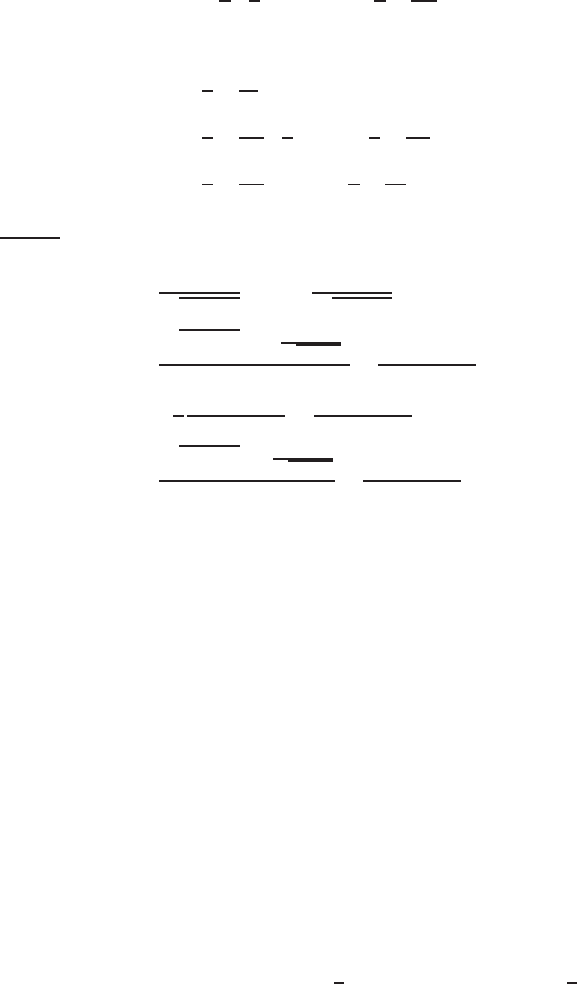
1336 Chapter Fourteen /SOLUTIONS
7. Since f(x, y) = sin(x/y), the first partial derivatives are:
fx= (cos ( x
y)) 1
y, fy= (cos ( x
y))( −x
y2).
Thus, the second partial derivatives are
fxx =−(sin ( x
y))( 1
y2)
fxy =−(sin ( x
y))( −x
y2)( 1
y) + (cos ( x
y))( −1
y2) = fyx
fyy =−(sin ( x
y))( −x
y2)2+ (cos ( x
y))( 2x
y3).
8. Since f(x, y) = px2+y2, we have
fx=x
px2+y2, fy=y
px2+y2
fxx =px2+y2−x(x
√x2+y2)
x2+y2=y2
(x2+y2)3/2
fxy =−1
2
x(2y)
(x2+y2)3/2=−xy
(x2+y2)3/2=fyx
fyy =px2+y2−yy
√x2+y2
(x2+y2)=x2
(x2+y2)3/2.
9. We have
fx= 15x2y2−7y3+ 18xand fy= 10x3y−21xy2,
so
fxx = 30xy2+ 18 and fxy = 30x2y−21y2and fyx = 30x2y−21y2and fyy = 10x3−42xy.
10. Since f(x, y) = sin(x2+y2), we have
fx= (cos (x2+y2))2x , fy= (cos (x2+y2))2y
fxx =−(sin (x2+y2))4x2+ 2 cos (x2+y2)
fxy =−(sin (x2+y2))4xy =fyx
fyy =−(sin (x2+y2))4y2+ 2 cos (x2+y2).
11. We have fx= 6 cos 2xcos 5yand fy=−15 sin 2xsin 5y, so fxx =−12 sin 2xcos 5y,fxy =−30 cos 2xsin 5y,
fyx =−30 cos 2xsin 5y, and fyy =−75 sin 2xcos 5y.
12. The quadratic Taylor expansion about (0,0) is given by
f(x, y)≈Q(x, y) = f(0,0) + fx(0,0)x+fy(0,0)y+1
2fxx(0,0)x2+fxy (0,0)xy +1
2fyy(0,0)y2.
First we find all the relevant derivatives
f(x, y) = (y−1)(x+ 1)2
fx(x, y) = 2(y−1)(x+ 1)
fy(x, y) = (x+ 1)2
fxx(x, y) = 2(y−1)
fyy(x, y) = 0
fxy(x, y) = 2(x+ 1)

14.7 SOLUTIONS 1337
Now we evaluate each of these derivatives at (0,0) and substitute into the formula to get as our final answer:
Q(x, y) = −1−2x+y−x2+ 2xy
Notice this is the same as what you get if you expand (y−1)(x+ 1)2and then keep only the terms of degree 2or less.
13. The quadratic Taylor expansion about (0,0) is given by
f(x, y)≈Q(x, y) = f(0,0) + fx(0,0)x+fy(0,0)y+1
2fxx(0,0)x2+fxy (0,0)xy +1
2fyy(0,0)y2.
First we find all the relevant derivatives
f(x, y) = (x−y+ 1)2
fx(x, y) = 2(x−y+ 1)
fy(x, y) = −2(x−y+ 1)
fxx(x, y) = 2
fyy (x, y) = 2
fxy (x, y) = −2
Now we evaluate each of these derivatives at (0,0) and substitute into the formula to get as our final answer:
Q(x, y) = 1 + 2x−2y+x2−2xy +y2
Notice this is the same as what you get if you expand (x−y+ 1)2.
14. The quadratic Taylor expansion about (0,0) is given by
f(x, y)≈Q(x, y) = f(0,0) + fx(0,0)x+fy(0,0)y+1
2fxx(0,0)x2+fxy (0,0)xy +1
2fyy(0,0)y2.
First we find all the relevant derivatives
f(x, y) = e−2x2−y2
fx(x, y) = −4xe−2x2−y2
fy(x, y) = −2ye−2x2−y2
fxx(x, y) = −4e−2x2−y2+ 16x2e−2x2−y2
fyy(x, y) = −2e−2x2−y2+ 4y2e−2x2−y2
fxy(x, y) = 8xye−2x2−y2
Now we evaluate each of these derivatives at (0,0) and substitute into the formula to get as our final answer:
Q(x, y) = 1 −2x2−y2
15. The quadratic Taylor expansion about (0,0) is given by
f(x, y)≈Q(x, y) = f(0,0) + fx(0,0)x+fy(0,0)y+1
2fxx(0,0)x2+fxy (0,0)xy +1
2fyy(0,0)y2.
First we find all the relevant derivatives
f(x, y) = excos y
fx(x, y) = excos y
fy(x, y) = −exsin y
fxx(x, y) = excos y
fyy(x, y) = −excos y
fxy (x, y) = −exsin y
Now we evaluate each of these derivatives at (0,0) and substitute into the formula to get as our final answer:
Q(x, y) = 1 + x+1
2x2−1
2y2
Notice this is the same as what you get if you multiply the quadratic approximations for exand cos y, that is (1 + x+
x2/2)(1 −y2/2), and then keep only the terms of degree 2or less.

1338 Chapter Fourteen /SOLUTIONS
16. The quadratic Taylor expansion about (0,0) is given by
f(x, y)≈Q(x, y) = f(0,0) + fx(0,0)x+fy(0,0)y+1
2fxx(0,0)x2+fxy (0,0)xy +1
2fyy(0,0)y2.
First we find all the relevant derivatives
f(x, y) = (1 + 2x−y)−1
fx(x, y) = −2(1 + 2x−y)−2
fy(x, y) = (1 + 2x−y)−2
fxx(x, y) = 8(1 + 2x−y)−3
fyy(x, y) = 2(1 + 2x−y)−3
fxy(x, y) = −4(1 + 2x−y)−3
Now we evaluate each of these derivatives at (0,0) and substitute into the formula to get as our final answer:
Q(x, y) = 1 −2x+y+ 4x2−4xy +y2
Notice this is the same as what you get if you substitute u=y−2xin the quadratic approximation Q(u) = 1 + u+u2
for 1/(1 −u).
17. The quadratic Taylor expansion about (0,0) is given by
f(x, y)≈Q(x, y) = f(0,0) + fx(0,0)x+fy(0,0)y+1
2fxx(0,0)x2+fxy (0,0)xy +1
2fyy(0,0)y2.
First we find all the relevant derivatives
f(x, y) = cos(x+ 3y)
fx(x, y) = −sin(x+ 3y)
fy(x, y) = −3 sin(x+ 3y)
fxx(x, y) = −cos(x+ 3y)
fyy(x, y) = −9 cos(x+ 3y)
fxy (x, y) = −3 cos(x+ 3y)
Now we evaluate each of these derivatives at (0,0) and substitute into the formula to get as our final answer:
Q(x, y) = 1 −1
2x2−3xy −9
2y2
Notice this is the same as what you get if you substitute x+ 3yfor uin the single variable quadratic approximation
Q(u) = 1 −u2/2for cos u.
18. The quadratic Taylor expansion about (0,0) is given by
f(x, y)≈Q(x, y) = f(0,0) + fx(0,0)x+fy(0,0)y+1
2fxx(0,0)x2+fxy (0,0)xy +1
2fyy(0,0)y2
So first we find all the relevant derivatives
f(x, y) = sin 2x+ cos y
fx(x, y) = 2 cos 2x
fy(x, y) = −sin y
fxx(x, y) = −4 sin 2x
fyy(x, y) = −cos y
fxy(x, y) = 0
We substitute into the formula to get for our answer:
Q(x, y) = 1 + 2x−1
2y2
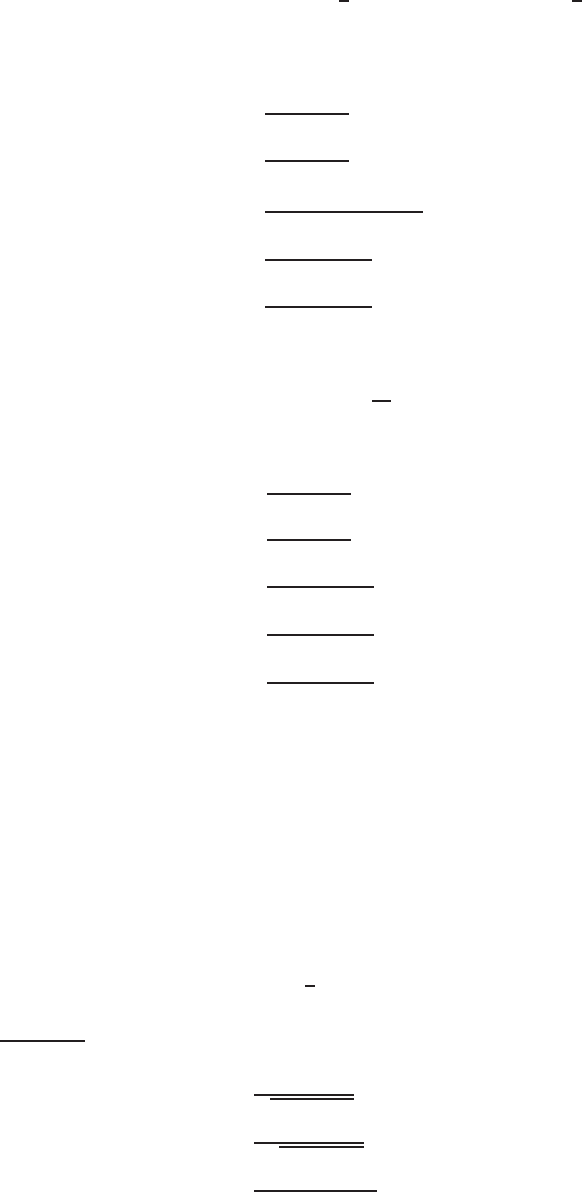
14.7 SOLUTIONS 1339
19. The quadratic Taylor expansion about (0,0) is given by
f(x, y)≈Q(x, y) = f(0,0) + fx(0,0)x+fy(0,0)y+1
2fxx(0,0)x2+fxy (0,0)xy +1
2fyy(0,0)y2.
So first we find all the relevant derivatives:
f(x, y) = ln(1 + x2−y)
fx(x, y) = 2x
1 + x2−y
fy(x, y) = −1
1 + x2−y
fxx(x, y) = 2(1 + x2−y)−4x2
(1 + x2−y)2
fyy(x, y) = −1
(1 + x2−y)2
fxy (x, y) = 2x
(1 + x2−y)2
Substituting into the formula we get as our answer:
Q(x, y) = −y+x2−y2
2
20. Since f(x, y) = ln(1 + x−2y), the first and second derivatives are
fx=1
1 + x−2y
fy=−2
1 + x−2y
fxx =−1
(1 + x−2y)2
fxy =2
(1 + x−2y)2
fyy =−4
(1 + x−2y)2,
so we find that
f(0,0) = 0
fx(0,0) = 1
fy(0,0) = −2
fxx(0,0) = −1
fxy(0,0) = 2
fyy(0,0) = −4.
The best quadratic approximation for f(x, y)for (x, y)near (0,0) is
f(x, y)≈x−2y−1
2x2+ 2xy −2y2.
21. Since f(x, y) = √1 + 2x−y, the first and second derivatives are
fx=1
√1 + 2x−y
fy=−1
2√1 + 2x−y
fxx =−1
(1 + 2x−y)3/2

1340 Chapter Fourteen /SOLUTIONS
fxy =1
2(1 + 2x−y)3/2
fyy =−1
4(1 + x−2y)3/2,
so we find that
f(0,0) = 1
fx(0,0) = 1
fy(0,0) = −1/2
fxx(0,0) = −1
fxy(0,0) = 1/2
fyy(0,0) = −1/4.
The best quadratic approximation for f(x, y)for (x, y)near (0,0) is
f(x, y)≈1 + x−1
2y−1
2x2+1
2xy −1
8y2.
22. (a) fx(P)<0because fdecreases as you go to the right.
(b) fy(P) = 0 because fdoes not change as you go up.
(c) fxx(P)>0because fxincreases as you go to the right (fxchanges from a large negative number to a small negative
number).
(d) fyy (P) = 0 because fydoes not change as you go up.
(e) fxy (P) = 0 because fxdoes not change as you go up.
23. (a) fx(P)<0because fdecreases as you go to the right.
(b) fy(P) = 0 because fdoes not change as you go up.
(c) fxx(P)<0because fxdecreases as you go to the right (fxchanges from a small negative number to a large negative
number).
(d) fyy (P) = 0 because fydoes not change as you go up.
(e) fxy (P) = 0 because fxdoes not change as you go up.
24. (a) fx(P)>0because fincreases as you go to the right.
(b) fy(P) = 0 because fdoes not change as you go up.
(c) fxx(P)<0because fxdecreases as you go to the right. (Since the level curves are further apart as you go to the
right, the rate of change of fdecreases. Thus, fxchanges from a large positive to a small positive number.)
(d) fyy (P) = 0 because fydoes not change as you go up.
(e) fxy (P) = 0 because fxdoes not change as you go up.
25. (a) fx(P)>0because fincreases as you go to the right.
(b) fy(P) = 0 because fdoes not change as you go up.
(c) fxx(P)>0because fxincreases as you go to the right. (The rate of change of fis larger when you go to the right
since the level curves are closer together. Thus fxchanges from a small positive to a large positive number.)
(d) fyy (P) = 0 because fydoes not change as you go up.
(e) fxy (P) = 0 because fxdoes not change as you go up.
26. (a) fx(P) = 0 because fdoes not change as you go to the right.
(b) fy(P)>0because fincreases as you go up.
(c) fxx(P) = 0 because fxdoes not change as you go to the right.
(d) fyy (P)<0because fydecreases as you go up (Since the level curves are further apart as you move up, the rate of
change of fis slower, that is, fydecreases as you move up.)
(e) fxy (P) = 0 because fxdoes not change as you go up.
27. (a) fx(P) = 0 because fdoes not change as you go to the right.
(b) fy(P)<0because fdecreases as you go up.
(c) fxx(P) = 0 because fxdoes not change as you go to the right.
(d) fyy (P)<0because fydecreases as you go up. (fychanges from a negative number with smaller magnitude to a
negative number with larger magnitude.)
(e) fxy (P) = 0 because fxdoes not change as you go up.
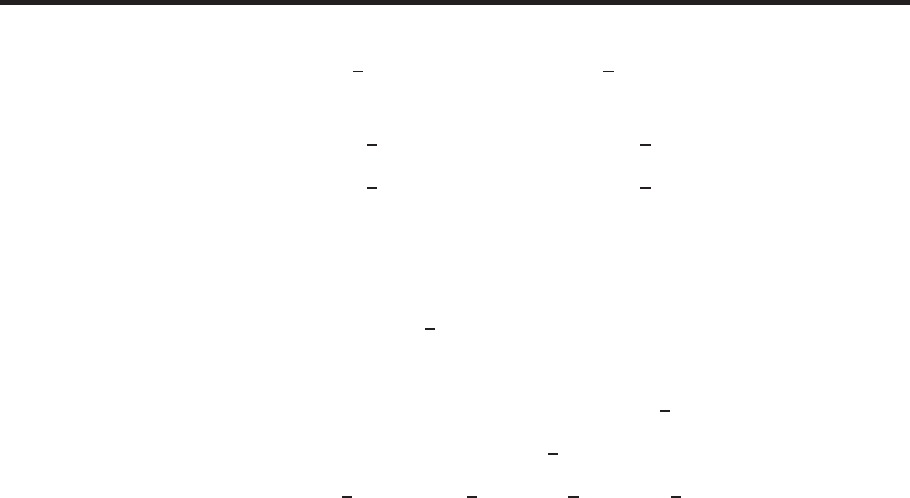
14.7 SOLUTIONS 1341
28. (a) fx(P)<0because fdecreases as you go to the right.
(b) fy(P)<0because fdecreases as you go up.
(c) fxx(P) = 0 because fxdoes not change as you go to the right. (Notice that the level curves are equidistant and
parallel, so the partial derivatives of fdo not change if you move horizontally or vertically.)
(d) fyy (P) = 0 because fydoes not change as you go up.
(e) fxy (P) = 0 because fxdoes not change as you go up.
29. (a) fx(P)>0because fincreases as you go to the right.
(b) fy(P)>0because fincreases as you go up.
(c) fxx(P) = 0 because fxdoes not change as you go to the right. (Notice that the level curves are equidistant and
parallel, so the partial derivatives of fdo not change if you move horizontally or vertically.)
(d) fyy (P) = 0 because fydoes not change as you go up.
(e) fxy (P) = 0 because fxdoes not change as you go up.
30. (a) fx(P)<0because fdecreases as you go to the right.
(b) fy(P)>0because fincreases as you go up.
(c) fxx(P)>0because fxincreases as you move right (fxchanges from negative numbers with larger magnitude to
negative numbers with smaller magnitude).
(d) fyy (P)>0because the level curves are closer together as you move up, so fyincreases as you go up.
(e) fxy (P)<0because the rate of change of fwith respect to xis a negative number at Pand a negative number with
larger magnitude higher up. Therefore fxdecreases as the point moves up.
31. (a) fx(P)>0because fincreases as you go to the right.
(b) fy(P)<0because fdecreases as you go up.
(c) fxx(P)<0because the level curves are further apart as you go to the right, so the rate of increase of fis slower as
you move to the right. Therefore, fxdecreases as you go to the right.
(d) fyy (P)<0because fydecreases as you move up (fychanges from a negative number with smaller magnitude to a
negative number with larger magnitude).
(e) fxy (P)>0because the rate of change of fwith respect to xat Pis lower than at points above P. Therefore fx
increases as you move up.
Problems
32. We have f(1,0) = 1 and the relevant derivatives are:
fx=1
2(x+ 2y)−1/2so fx(1,0) = 1
2
fy= (x+ 2y)−1/2so fy(1,0) = 1
fxx =−1
4(x+ 2y)−3/2so fxx(1,0) = −1
4
fxy =−1
2(x+ 2y)−3/2so fxy (1,0) = −1
2
fyy =−(x+ 2y)−3/2so fyy (1,0) = −1.
Thus the linear approximation, L(x, y)to f(x, y)at (1,0), is given by:
f(x, y)≈L(x, y) = f(1,0) + fx(1,0)(x−1) + fy(1,0)(y−0)
= 1 + 1
2(x−1) + y .
The quadratic approximation, Q(x, y)to f(x, y)near (1,0), is given by:
f(x, y)≈Q(x, y) = f(1,0) + fx(1,0)(x−1) + fy(1,0)(y−0) + 1
2fxx(1,0)(x−1)2
+fxy (1,0)(x−1)(y−0) + 1
2fyy(1,0)(y−0)2
= 1 + 1
2(x−1) + y−1
8(x−1)2−1
2(x−1)y−1
2y2.
The values of the approximations are
L(0.9,0.2) = 1 −0.05 + 0.2 = 1.15
Q(0.9,0.2) = 1 −0.05 + 0.2−0.00125 + 0.01 −0.02 = 1.13875

1342 Chapter Fourteen /SOLUTIONS
and the exact value is
f(0.9,0.2) = √1.3≈1.14018.
Observe that the quadratic approximation is closer to the exact value.
33. We have f(1,0) = 0 and the relevant derivatives are:
fx= 2xy so fx(1,0) = 0
fy=x2so fy(1,0) = 1
fxx = 2yso fxx(1,0) = 0
fxy = 2xso fxy(1,0) = 2
fyy = 0 so fyy(1,0) = 0 .
Thus the linear approximation, L(x, y)to f(x, y)at (1,0), is given by:
f(x, y)≈L(x, y) = f(1,0) + fx(1,0)(x−1) + fy(1,0)(y−0)
=y .
The quadratic approximation, Q(x, y)to f(x, y)near (1,0), is given by:
f(x, y)≈Q(x, y) = f(1,0) + fx(1,0)(x−1) + fy(1,0)(y−0) + 1
2fxx(1,0)(x−1)2
+fxy (1,0)(x−1)(y−0) + 1
2fyy(1,0)(y−0)2
=y+ 2(x−1)y .
The values of the approximations are
L(0.9,0.2) = 0.2
Q(0.9,0.2) = 0.2 + 2(−0.1)(0.2) = 0.16
and the exact value is
f(0.9,0.2) = (0.81)(0.2) = 0.162.
Observe that the quadratic approximation is closer to the exact value.
34. We have f(1,0) = 1 and the relevant derivatives are:
fx=e−yso fx(1,0) = 1
fy=−xe−yso fy(1,0) = −1
fxx = 0 so fxx(1,0) = 0
fxy =−e−yso fxy (1,0) = −1
fyy =xe−yso fyy (1,0) = 1 .
Thus the linear approximation, L(x, y)to f(x, y)at (1,0), is given by:
f(x, y)≈L(x, y) = f(1,0) + fx(1,0)(x−1) + fy(1,0)(y−0)
= 1 + (x−1) −y .
The quadratic approximation, Q(x, y)to f(x, y)near (1,0), is given by:
f(x, y)≈Q(x, y) = f(1,0) + fx(1,0)(x−1) + fy(1,0)(y−0) + 1
2fxx(1,0)(x−1)2
+fxy (1,0)(x−1)(y−0) + 1
2fyy(1,0)(y−0)2
= 1 + (x−1) −y−(x−1)y+1
2y2.
The values of the approximations are
L(0.9,0.2) = 1 −0.1−0.2 = 0.7
Q(0.9,0.2) = 1 −0.1−0.2 + 0.02 + 0.02 = 0.74
and the exact value is
f(0.9,0.2) = (0.9)e−0.2≈0.737
Observe that the quadratic approximation is closer to the exact value.

14.7 SOLUTIONS 1343
35. Differentiating, we get
Fx=exsin y+eycos x Fy=excos y+eysin x
Fxx =exsin y−eysin x Fyy =−exsin y+eysin x=−Fxx
Thus, Fxx +Fyy = 0.
36. We have f(1,0) = 0 and the relevant derivatives are:
fx= cos(x−1) cos yso fx(1,0) = 1
fy=−sin(x−1) sin yso fy(1,0) = 0
fxx =−sin(x−1) cos yso fxx(1,0) = 0
fxy =−cos(x−1) sin yso fxy(1,0) = 0
fyy =−sin(x−1) cos yso fyy (1,0) = 0 .
Thus the linear approximation, L(x, y)to f(x, y)at (1,0), is given by:
f(x, y)≈L(x, y) = f(1,0) + fx(1,0)(x−1) + fy(1,0)(y−0)
=x−1.
The quadratic approximation, Q(x, y)to f(x, y)near (1,0), is given by:
f(x, y)≈Q(x, y) = f(1,0) + fx(1,0)(x−1) + fy(1,0)(y−0) + 1
2fxx(1,0)(x−1)2
+fxy (1,0)(x−1)(y−0) + 1
2fyy(1,0)(y−0)2
=x−1.
Thus the linear and quadratic approximations are the same. The values of the approximations are
L(0.9,0.2) = Q(0.9,0.2) = −0.1,
and the exact value is
f(0.9,0.2) = sin(−0.1) cos(0.2) ≈ −0.098
37. Differentiating, we get
Fx=−e−xsin y, Fy=e−xcos y, Fxx =e−xsin y, Fyy =−e−xsin y=−Fxx.
Thus, Fxx +Fyy = 0.
38. Differentiating, we get
Fx=1
1 + ( y
x)(−y
x2) = −y
x2+y2
Fy=1
1 + ( y
x)2(1
x) = x
x2+y2
Fxx = (−y)−1
(x2+y2)2(2x) = 2xy
(x2+y2)2
Fyy =−x
(x2+y2)2(2y) = −2xy
(x2+y2)2=−Fxx
Thus, Fxx +Fyy = 0.
39. First let us take the partial derivatives:
ut=aeat sin (bx)
ux=beat cos (bx)
uxx =−b2eat sin (bx)
Substituting into the equation, we have
aeat sin (bx) = ut=uxx =−b2eat sin (bx)
So, a=−b2.
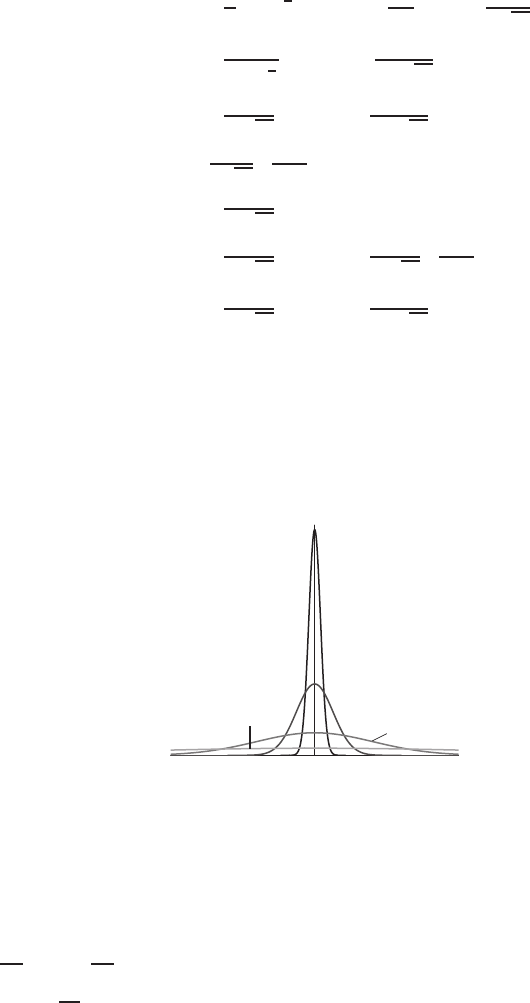
1344 Chapter Fourteen /SOLUTIONS
40. (a) Taking partial derivatives of u, we get
ut=−π
4(πt)−3
2e−x2/(4t)+x2
4t2e−x2/(4t)1
2√πt
=−π
4(πt)3
2
e−x2/(4t)+x2
8t2√πt e−x2/(4t)
=−1
4t√πt e−x2/(4t)+x2
8t2√πt e−x2/(4t)
ux=1
2√πt −2x
4te−x2/(4t)
=−x
4t√πt e−x2/(4t)
uxx =−1
4t√πt e−x2/(4t)−x
4t√πt −2x
4te−x2/(4t)
=−1
4t√πt e−x2/(4t)+x2
8t2√πt e−x2/(4t)
So we have
ut=uxx,
showing that usatisfies the heat equation.
(b) See Figure 14.32. Note that as time progresses the heat at the origin decreases and flows out toward the ends of the
rod, until at t= 10 the temperature appears to be leveling out toward being constant throughout the rod.
x
u(x, 0.01)
u(x, 0.1)
✙u(x, 1)
❄
u(x, 10)
Figure 14.32
41. The graph of fis concave up as we move parallel to the x-axis from the point (0,0), so fxx(0,0) is positive. The graph
of fis concave down as we move parallel to the y-axis from the point (0,0), so fyy (0,0) is negative.
42. Since zy=g(x), zyy = 0, because gis a function of xonly.
43. (a) zyx =zxy = 4y
(b) zxyx =∂
∂x (zxy) = ∂
∂x (4y) = 0
(c) zxyy =zyxy =∂
∂y (4y) = 4
44. (a) Moving parallel to the x-axis means that the z-labels on the contours increase, so zis an increasing function of x.
Moving parallel to the y-axis, the z-labels decrease, so zis a decreasing function of y.
(b) Since zis an increasing function of x, we have fx>0. Similarly, fy<0.
(c) Since the contours get closer together as we move parallel to the x-axis, we have fxx >0. This means that zis
increasing faster and faster as xincreases. Similar reasoning shows that fyy <0.
(d) The vector grad fis perpendicular to the level curves and points in the direction of increasing fvalues. See Fig-
ure 14.33.
(e) The vector grad fis longer at Pbecause the contours are closer together at Pthan at Q.
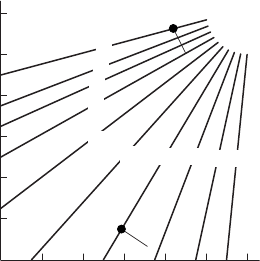
14.7 SOLUTIONS 1345
1 2 3 4 5 6
1
2
3
4
5
6
❯
s
P
Q
1
2
3
4
5
67 8 9 10
x
y
Figure 14.33
45. The table of values is linear, because all the rows are linear and have the same slope, 1, and all the columns are linear and
have the same slope, 2. A linear function has no quadratic terms, so the coefficients of x2,xy, and y2are all zero. We
have d=e=f= 0.
46. The rows of the table are not linear, so there is at least one nonzero quadratic term in the polynomial P(x, y). The
coefficients of the quadratic terms are closely related to the second order partial derivatives.
Since the x-slope increases as we move along a row in the direction of increasing x, we have ∂2P/∂x2>0. Hence
d= (∂2P/∂x2)/2>0.
Since the y-slope is constant as we move across the table in the direction of increasing x, we have ∂/∂x(∂P/∂y) =
0. Hence e=∂2P/∂x∂y = 0.
Since the y-slope is constant as we move down a column in the direction of increasing y, we have ∂2P/∂y2= 0.
Hence f= (∂2P/∂y2)/2 = 0.
47. The rows of the table are linear but they do not all have the same slope, so the polynomial P(x, y)is not linear. Alterna-
tively, since the columns of the table are not linear, P(x, y)is not linear. There is at least one nonzero quadratic term in
P. The coefficients of the quadratic terms are closely related to the second order partial derivatives.
Since the x-slope is constant as we move across a row in the direction of increasing x, we have ∂2P/∂x2= 0.
Hence d= (∂2P/∂x2)/2 = 0.
Since the x-slope increases as we move down the table in the direction of increasing y, we have ∂/∂y(∂P/∂x)>0.
Hence e=∂2P/∂y∂x > 0.
Since the y-slope decreases as we move down a column in the direction of increasing y, we have ∂2P/∂y2<0.
Hence f= (∂2P/∂y2)/2<0.
48. Neither the rows nor the columns of the table are linear, so the polynomial P(x, y)is not linear. There is at least one
nonzero quadratic term in P. The coefficients of the quadratic terms are closely related to the second order partial deriva-
tives.
Since the x-slope increases as we move across a row in the direction of increasing x, we have ∂2P/∂x2>0. Hence
d= (∂2P/∂x2)/2>0.
Since the x-slope decreases as we move down the table in the direction of increasing y, we have ∂/∂y(∂P/∂x)<0.
Hence e=∂2P/∂y∂x < 0.
Since the y-slope increases as we move down a column in the direction of increasing y, we have ∂2P/∂y2>0.
Hence f= (∂2P/∂y2)/2>0.
49. (a) The vertical spacing between the contours just north and just south of the trail increases as you move eastward along
the trail.

1346 Chapter Fourteen /SOLUTIONS
Trail
1000
1010
1020
990
980
Elevation in meters
Figure 14.34
(b) Let h=f(x, y), where his elevation in meters, and xand yare distances in meters east and north of the start of the
trail. Hence the trail begins at (0,0) and lies along the line y= 0. We also know:
•The trail is level. Hence ∂h/∂x = 0 at all points of the trail.
•There is a mountain to the left. Hence ∂h/∂y > 0at all points of the trail.
•The slope up to the left is getting more gentle as you hike east. Thus ∂h/∂y is a decreasing function of x. Hence
∂/∂x(∂h/∂y) = (∂2h)/(∂x∂y)<0.
(c) The decision to delay turning off the trail was based on the second mixed partial, (∂2h)/(∂x∂y).
50. (a) Increasing Lcauses production Yto increase, so ∂Y /∂L > 0.
(b) The increase in production resulting from hiring an additional worker is approximately ∂Y /∂L. This number is larger
for larger values of K, so ∂Y /∂L is an increasing function of K. Its derivative with respect to Kis positive. Hence
∂
∂K ∂Y
∂L =∂2Y
∂K∂L >0.
51. (a) Person A. Weight gain of 1 pound results in an approximate surface area increase of ∂S/∂w. We know that ∂S/∂w
is an increasing function of height h, because
∂
∂h ∂S
∂w >0.
Thus ∂S/∂w is larger for the taller person, A.
(b) Person B. Weight gain of 1 pound results in an approximate surface area increase of ∂S/∂w. We know that ∂S/∂w
is a decreasing function of weight w, because
∂
∂w ∂S
∂w <0.
Thus ∂S/∂w is greater for the lighter person, B.
52. (a) Since Pand Qlie on the same level curve, we have a=k.
(b) We have b=fxand c=fy. Since the gradient of fat P(respectively Q) points toward Mor away from M, from
the figure, we see fx(P)and fy(P)have opposite signs, while fx(Q)and fy(Q)have the same signs. Thus Qis the
point (x1, y1), so Pis (x2, y2).
(c) Since b=fx(Q)>0and c=fy(Q)>0, the value of fmust increase as we go away from M. Thus, Mmust be a
minimum (the surface is a valley).
(d) Since Mis a minimum, m=fx(P)<0and n=fy(P)>0.
53. (a) Calculate the partial derivatives:
f(x, y) = sin xsin y f(0,0) = 0 f(π
2,π
2) = 1
fx(x, y) = cos xsin y fx(0,0) = 0 fx(π
2,π
2) = 0
fy(x, y) = sin xcos y fy(0,0) = 0 fy(π
2,π
2) = 0
fxx(x, y) = −sin xsin y fxx(0,0) = 0 fxx(π
2,π
2) = −1
fxy(x, y) = cos xcos y fxy(0,0) = 1 fxy (π
2,π
2) = 0
fyy(x, y) = −sin xsin y fyy(0,0) = 0 fyy(π
2,π
2) = −1
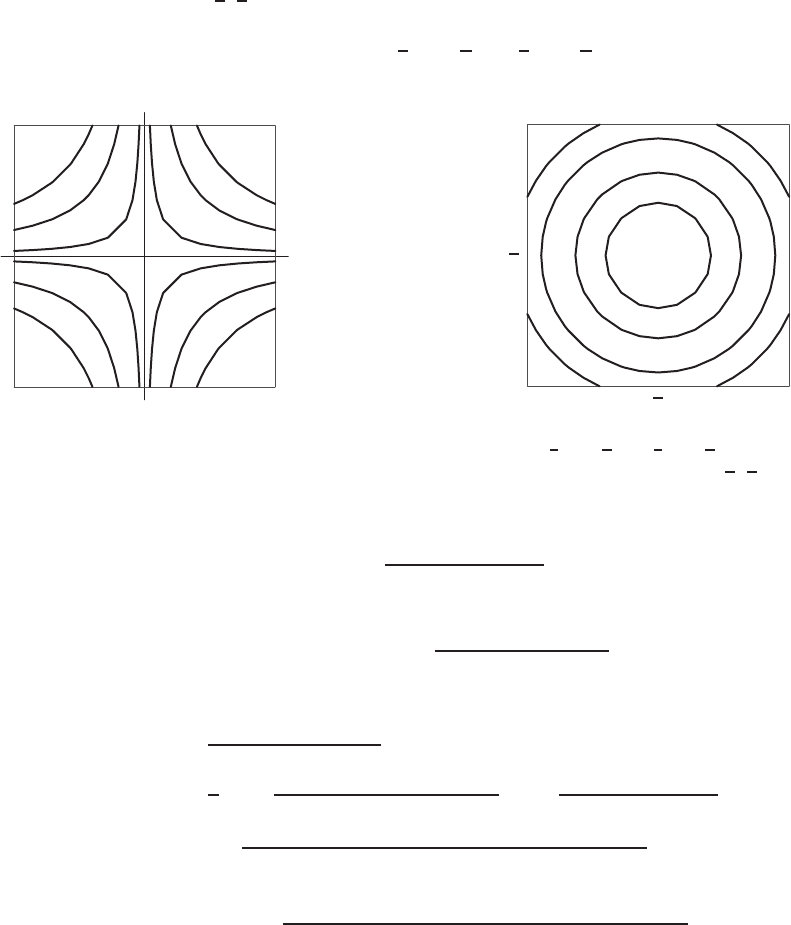
14.7 SOLUTIONS 1347
Thus, the Taylor polynomial about (0,0) is
f(x, y)≈Q1(x, y) = xy.
The Taylor polynomial about (π
2,π
2)is
f(x, y)≈Q2(x, y) = 1 −1
2x−π
22
−1
2y−π
22
.
(b)
x
y
0
0
Figure 14.35
:f(x, y)≈xy: Quadratic
approximation about (0,0)
x
y
π
2
π
2
Figure 14.36
:f(x, y)≈
1−1
2(x−π
2)2−1
2(y−π
2)2: Quadratic
approximation about (π
2,π
2)
54. (a) The definition of fxis:
fx(a, b) = lim
h→0
f(a+h, b)−f(a, b)
h.
(b) We define fxy = (fx)yas follows:
fxy (a, b) = (fx)y(a, b) = lim
k→0
fx(a, b +k)−fx(a, b)
k.
(c) Substituting the expression for fxinto the definition fxy :
fxy (a, b) = lim
k→0
fx(a, b +k)−fx(a, b)
k
= lim
k→0
1
klim
h→0
f(a+h, b +k)−f(a, b +k)
h−lim
h→0
f(a+h, b)−f(a, b)
h
= lim
k→0lim
h→0
f(a+h, b +k)−f(a, b +k)−f(a+h, b) + f(a, b)
hk .
(d) Similarly,
fyx(a, b) = lim
h→0lim
k→0
f(a+h, b +k)−f(a+h, b)−f(a, b +k) + f(a, b)
hk .
(e) The numerators in the two expressions in part (c) and (d) are the same (just swap the middle terms), so the only
difference between them is the order in which the limits are taken. To be sure fxy and fyx are equal, we have to
assume we can swap the order of the limits. Swapping limits can be a tricky business, but it can be done in this case
if fxy and fyx are continuous.
55. (a) (i) Dollars/Year. Negative. The value of the car decreases with age.
(ii) Dollars/Dollar. Positive. For two cars of the same age, the one that had the highest value when new costs more
now.
(b) The experts say that ∂P/∂C is a decreasing function of age. This means that ∂/∂A(∂P/∂C) = ∂2P/(∂A∂C)<0.
(c) The term eCA, because ∂2P/(∂A∂C) = e.
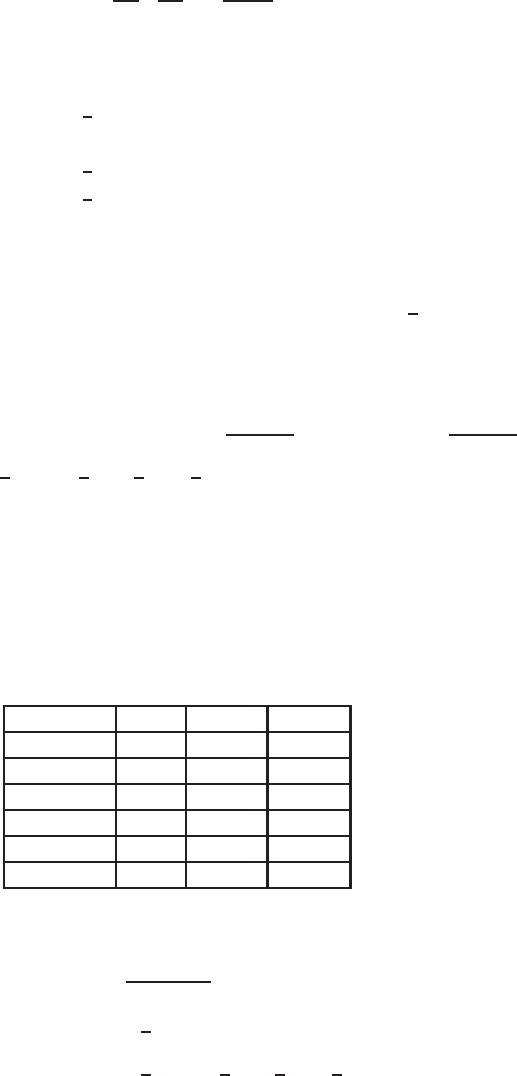
1348 Chapter Fourteen /SOLUTIONS
56. (a) (II) At first ∂T/∂S > 0, but after increasing S, we have ∂T/∂S < 0. Hence ∂T/∂S is a decreasing function of S.
This means that ∂2T/∂S2<0.
(b) (I) At first ∂T/∂V > 0, but after increasing V, we have ∂T/∂V < 0. Hence ∂T/∂V is a decreasing function of V.
This means that ∂2T/∂V 2<0.
(c) (III) At first ∂T/∂S < 0, but after increasing V, we have ∂T/∂S > 0. Hence ∂T /∂S is an increasing function of
V. This means that
∂
∂V ∂T
∂S =∂2T
∂V ∂S >0.
57. Let us first calculate the values of all the partial derivatives at (0,0) that we need:
f(x, y) = (x+ 2y+ 1)1/2, f(0,0) = 1,
fx(x, y) = 1
2(x+ 2y+ 1)−1/2, fx(0,0) = 1/2,
fy(x, y) = (x+ 2y+ 1)−1/2, fy(0,0) = 1,
fxx(x, y) = −1
4(x+ 2y+ 1)−3/2, fxx(0,0) = −1/4,
fxy(x, y) = −1
2(x+ 2y+ 1)−3/2, fxy (0,0) = −1/2,
fyy(x, y) = −(x+ 2y+ 1)−3/2, fyy (0,0) = −1.
(a) The local linearization L(x, y)of fat (0,0) is given by
f(x, y)≈L(x, y) = f(0,0) + fx(0,0)x+fy(0,0)y= 1 + 1
2x+y.
(b) The second-order Taylor polynomial, Q(x, y), for fat (0,0) is given by
f(x, y)≈Q(x, y)
=f(0,0) + fx(0,0)x+fy(0,0)y+fxx(0,0)
2x2+fxy (0,0)xy +fyy(0,0)
2y2
= 1 + 1
2x+y−1
8x2−1
2xy −1
2y2.
Notice that the local linearization of fis the same as the linear part of the Taylor polynomial of degree 2 for f. The
extra terms in the Taylor polynomial of degree 2 can be thought of as “correction terms” to the linear approximation.
(c) Table 14.8 records the values of f(x, y),L(x, y), and Q(x, y). Observe that the quadratic approximations Q(x, y)
are closer to the true values f(x, y)than are the linear approximations L(x, y). Of course both approximations are
exact at (0,0).
Table 14.8
Linear and quadratic approximations to
fnear (0,0)
Point Linear Quadratic True
(x, y)L(x, y)Q(x, y)f(x, y)
(0,0) 1 1 1
(0.1,0.1) 1.15 1.13875 1.140175
(−0.1,0.1) 1.05 1.04875 1.048809
(0.1,−0.1) 0.95 0.94875 0.948683
(−0.1,−0.1) 0.85 0.83875 0.836660
58. The contour diagrams in Figures 14.37–14.42 use the fact that
f(x, y) = px+ 2y+ 1,
L(x, y) = 1 + 1
2x+y,
Q(x, y) = 1 + 1
2x+y−1
8x2−1
2xy −1
2y2.
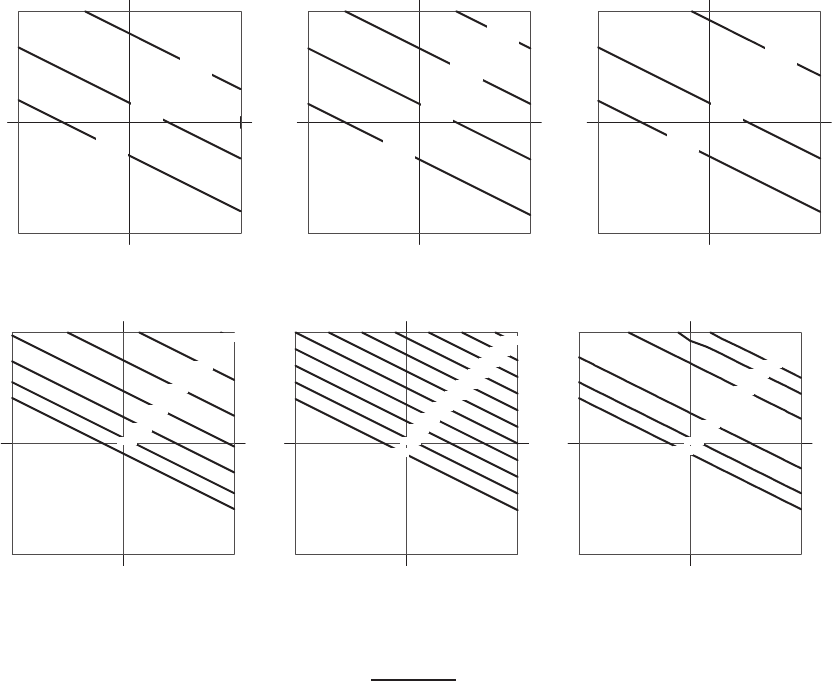
14.7 SOLUTIONS 1349
−0.6 0.6
−0.6
0.6
0.8
1.1
1.4
x
y
Figure 14.37
:f(x, y)
−0.6 0.6
−0.6
0.6
0.8
1.1
1.4
1.7
x
y
Figure 14.38
:L(x, y)
−0.6 0.6
−0.6
0.6
0.8
1.1
1.4
x
y
Figure 14.39
:Q(x, y)
−2 2
−2
2
0.8
1.1
1.4
1.7
2.0
2.3
2.6
x
y
Figure 14.40
:f(x, y)
−2 2
−2
2
0.8
1.1
1.4
1.7
2.0
2.3
2.6
2.9
3.2
3.5
3.8
x
y
Figure 14.41
:L(x, y)
−2 2
−2
2
0.8
1.1
1.4
1.4
1.1
0.8
x
y
Figure 14.42
:Q(x, y)
The contours for f(x, y)and L(x, y)are straight lines; those for L(x, y)are equally spaced because L(x, y)is a
linear function. The contours for f(x, y)are straight lines because if we set
f(x, y) = px+ 2y+ 1 = constant
then
x+ 2y+ 1 = constant.
However, the contours of f(x, y)are not equally spaced because f(x, y)is not linear.
In the “close up” diagram [−0.6,0.6]×[−0.6,0.6], the contours of Q(x, y)look like lines (though they are not). The
contour diagram of Q(x, y)is more similar to the contour diagram of f(x, y)than is L(x, y). This is because Q(x, y)is
a better approximation to f(x, y)than is L(x, y).
In the [−2,2] ×[−2,2] diagram, the values on the level curves of L(x, y)and Q(x, y)show that neither of them is
a good approximation to f(x, y)away from the origin.
59. Letting G(t) = f(t, 0) so that G′(t) = fx(t, 0), the Fundamental Theorem tells us that Ra
t=0G′(t)dt =G(a)−G(0).
Thus Za
t=0
fx(t, 0)dt =f(a, 0) −f(0,0)
Letting H(t) = f(a, t)so that H′(t) = fy(a, t), the Fundamental Theorem tells us that Rb
t=0H′(t)dt =H(b)−H(0).
Thus Zb
t=0
fy(a, t)dt =f(a, b)−f(a, 0)
Thus
f(0,0) + Za
t=0
fx(t, 0)dt +Zb
t=0
fy(a, t)dt
=f(0,0) + (f(a, 0) −f(0,0)) + (f(a, b)−f(a, 0))
=f(a, b).
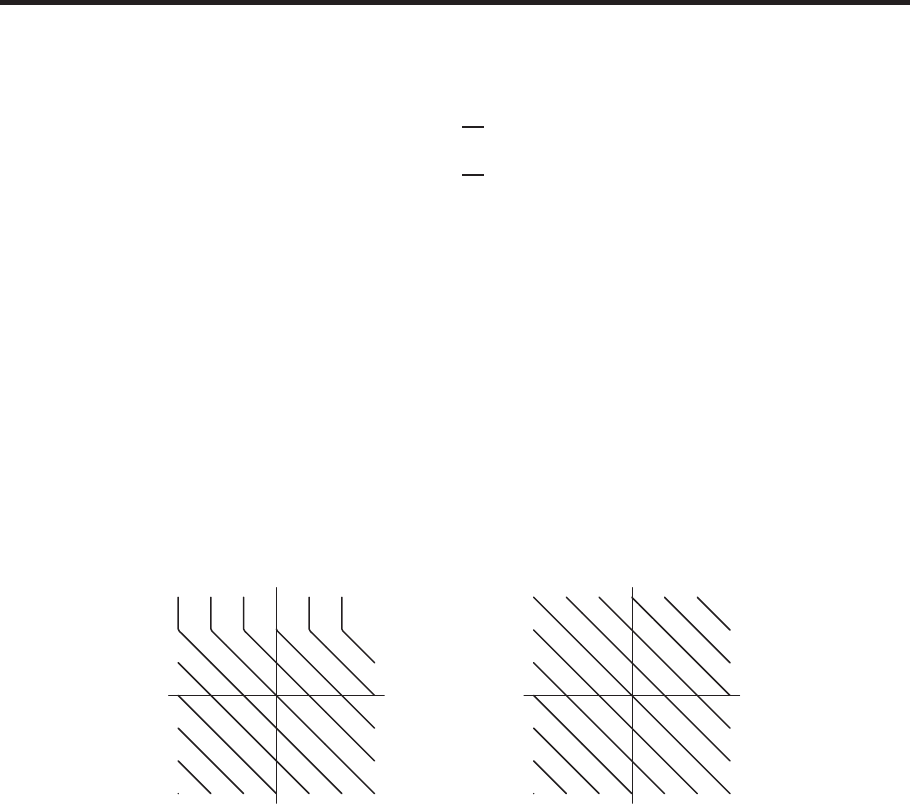
1350 Chapter Fourteen /SOLUTIONS
60. We have
|f(a, b)|=f(0,0) + Za
t=0
fx(t, 0)dt +Zb
t=0
fy(a, t)dt
≤ |f(0,0)|+Za
t=0
fx(t, 0)dt+Zb
t=0
fy(a, t)dt
≤0 + Za
t=0 |fx(t, 0)|dt+Zb
t=0 |fy(a, t)|dt
≤Za
t=0
Adt+Zb
t=0
Bdt
=A|a|+B|b|
Strengthen Your Understanding
61. The function f(x, y) = x3+y4is not the zero function. Nevertheless, the values of f,fx,fy,fxx,fxy , and fyy at (0,0)
are all zero. Therefore, the quadratic approximation of fnear (0,0) is the zero function.
62. If fx=xy and fy=y2, then
fxy =∂
∂y xy =x
fyx =∂
∂x y2= 0.
Since fxy and fyx are continuous, we expect fxy =fyx. Thus there is no function fwith the given partial derivatives.
63. One example is f(x, y) = x2+y2. More generally, functions of the form f(x, y) = g(x) + h(y)with g′′ 6= 0 and
h′′ 6= 0 all have fxx 6= 0,fyy 6= 0, and fxy = 0.
64. Since the quadratic approximation of a function near (0,0) depends only on the values of the function and its first and
second order partial derivatives at (0,0), changing a function by adding another function for which all these values are
zero does not change the quadratic approximation. For example, adding x3to a function f(x, y)does not change the
quadratic approximation near (0,0).
For example, f(x, y) = 2x+y2and g(x, y) = 2x+y2+x3both have quadratic approximation Q(x, y) = 2x+y2
near (0,0).
65. If fand ghave exactly the same contour diagrams inside a circle about the origin, then any partial derivative of fof
any order has the same value at the point (0,0) as the corresponding partial derivative of g. Since the Taylor polynomials
of degree 2 for fand gnear (0,0) are constructed from the values of the partial derivatives at (0,0), the two Taylor
polynomials are identical. It makes no difference what the contour diagrams look like outside the circle. See Figure 14.43
for one possible solution.
f(x, y)
x
yg(x, y)
x
y
Figure 14.43
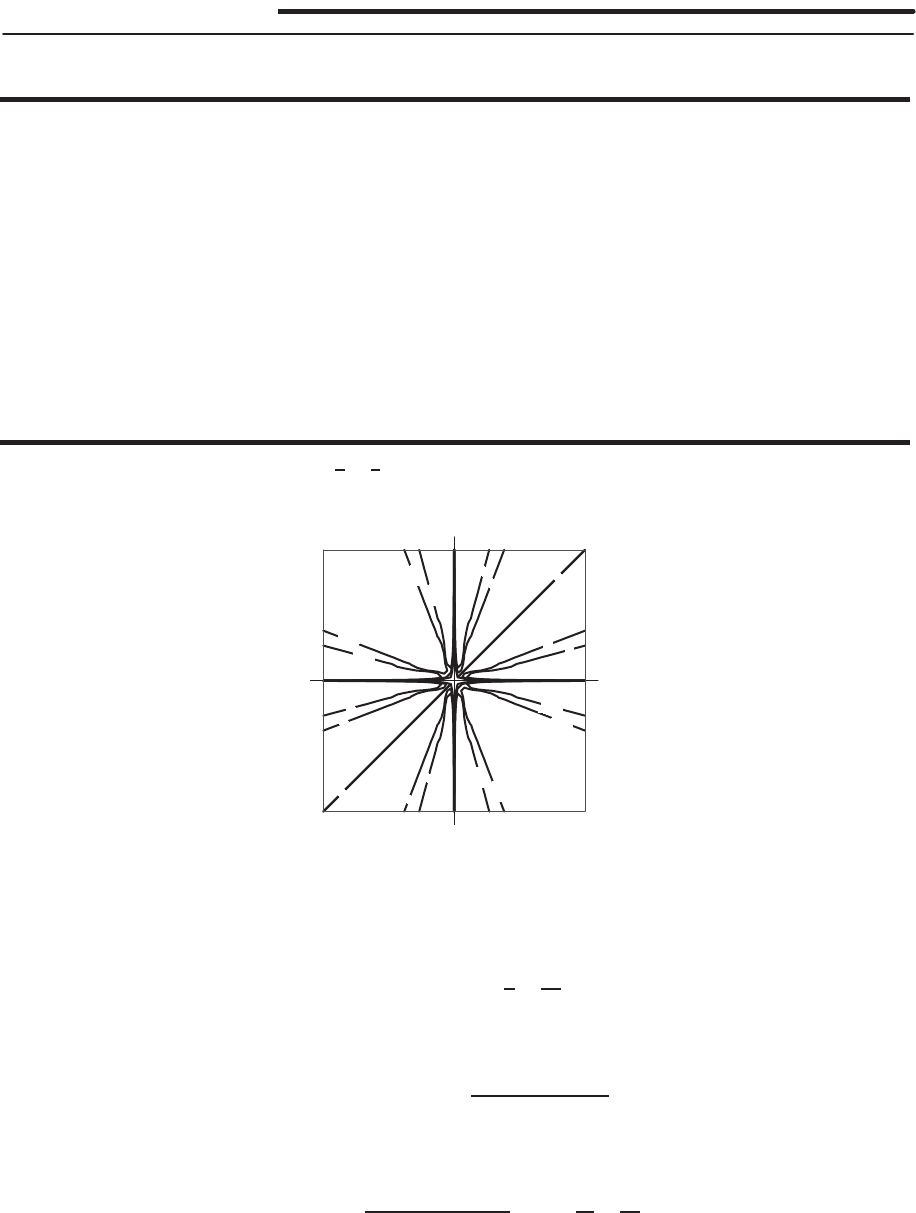
14.8 SOLUTIONS 1351
Solutions for Section 14.8
Exercises
1. Not differentiable at (0,0).
2. Not differentiable at (−1,0).
3. Not differentiable at all points on the xor yaxes.
4. Not differentiable where x=−2or where y= 3; that is not differentiable at all points on the lines x=−2and y= 3.
5. Differentiable at all points.
6. Not differentiable where x= 0; that is, not differentiable on y-axis.
7. Differentiable everywhere, since |x−3|2= (x−3)2.
8. Differentiable at all points, since cos |y|= cos y.
9. Not differentiable at (1,2).
10. Differentiable at all points.
Problems
11. (a) The contour diagram for f(x, y) = x
y+y
xis shown in Figure 14.44.
22
4
4
3
34
3
4
3
−4
−3
−3
−4
−3
−4
−3
−4
−2 2
−2
2
x
y
Figure 14.44
(b) If x6= 0 and y6= 0 then fis differentiable at (x, y). Now we need to look at points of the form (x, 0), where x6= 0
and (0, y), where y6= 0. The function fis not differentiable at these points as it is not continuous.
(c) For x6= 0 and y6= 0,
fx(x, y) = 1
y−y
x2.
So fxexists for x6= 0,y6= 0, and it is continuous.
For all points (x0,0) on the x-axis we have:
fx(x0,0) = lim
x→x0
f(x,0) −f(x0,0)
x−x0
= 0.
Thus, fxexists but is not continuous at these points.
For points (0, y0)on the y-axis we have:
lim
x→0
f(x, y0)−f(0, y0)
x= lim
x→0(1
y0
+y0
x2).
This limit does not exist, so the partial derivative fx(0, y0)does not exist.

1352 Chapter Fourteen /SOLUTIONS
Similarly, for x6= 0 and y6= 0,
fy(x, y) = −x
y2+1
x.
For points (0, y0)on the y-axis we have fy(0, y0) = 0, while fy(x0,0) does not exist for x06= 0.
Both fx(x, y)and fy(x, y)are continuous at (x, y)only for x6= 0 and y6= 0.
(d) We claim fis not continuous at (0,0). Let x=tand y=t, where t→0,t6= 0. Then
f(x, y) = f(t, t) = 2,for t6= 0.
So,
lim
t→0f(t, t) = 2 6=f(0,0) = 0,
and therefore
lim
(x,y)→(0,0) f(x, y)6=f(0,0).
Thus, fis not differentiable at (0,0) since fis not continuous at (0,0).
(e) From part (c) we have fx(0,0) = 0 and fy(0,0) = 0. The functions fxand fyare not continuous at (0,0).
12. (a) The contour diagram for f(x, y) = 2xy/(x2+y2)2is shown in Figure 14.45.
−2 2
−2
2
x
y
.25
.51
.25
.5
1
−.25
−.5
−1
−1
−.5
−.25
Figure 14.45
(b) The function fis differentiable at all points (x, y)6= (0,0), as it is a rational fraction with denominator (x2+y2)2=
0only when (x, y) = (0,0).
(c) The partial derivatives of fat points (x, y)6= (0,0) are given by
fx(x, y) = 2y(y2−3x2)
(x2+y2)3,
fy(x, y) = 2x(x2−3y2)
(x2+y2)3.
Both fxand fyare continuous for (x, y)6= (0,0).
(d) The function fis not continuous at (0,0). To see this, let x=y=tfor t6= 0. Then,
f(x, y) = f(t, t) = 2t2
4t4=1
2t2,
and so limt→0f(t, t)does not exist. Hence, fis not differentiable at (0,0).
(e) At (0,0), the partial derivatives of fare given by
fx(0,0) = lim
x→0
f(x, 0) −f(0,0)
x= lim
x→0
0−0
x= 0,
fy(0,0) = lim
y→0
f(0, y)−f(0,0)
y= lim
y→0
0−0
y= 0.
We claim that lim(x,y)→(0,0) fx(x, y)does not exist. To see this, let x=y=tfor t6= 0. Then,
fx(x, y) = fx(t, t) = 2t(t2−3t2)
(2t2)3=−4t3
8t6=−1
2t3
and so the limit
lim
t→0fx(t, t) = lim
t→0−1
2t3
does not exist. Hence, fxis not continuous at (0,0). Similarly, fyis not continuous at (0,0).
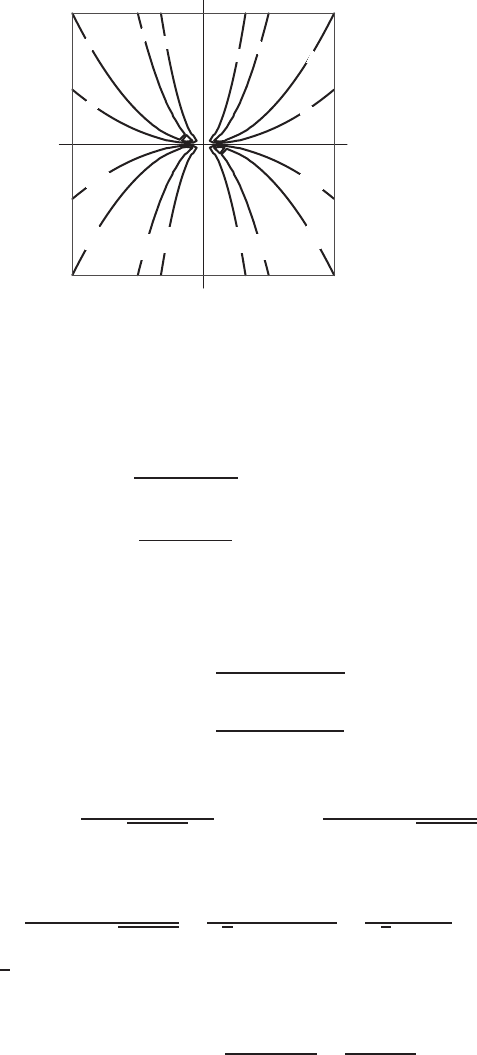
14.8 SOLUTIONS 1353
13. (a) The contour diagram for f(x, y) = x2y/(x4+y2)is shown in Figure 14.46.
−2 2
−2
2
x
y
−.2
−.4
−.2
−.4
.2
.4
.2
.4
−.2
−.4
−.2
−.4
.2
.4
.2
.4
Figure 14.46
(b) The function fis differentiable at all (x, y)6= (0,0) as it is a rational fraction with denominator which is zero only
when (x, y) = (0,0).
(c) The partial derivatives of fare given by
fx(x, y) = 2xy(y2−x4)
(x4+y2)2,for (x, y)6= (0,0),
fy(x, y) = x2(x4−y2)
(x4+y2)2,for (x, y)6= (0,0).
Both fxand fyare continuous at (x, y)6= (0,0).
(d) We use the definition of differentiability. If fwere differentiable at (0,0), then the linear approximation of fat (0,0)
would be L(x, y) = mx +ny, where m=fx(0,0) and n=fy(0,0). We have
fx(0,0) = lim
x→0
f(x, 0) −f(0,0)
x= 0,
fy(0,0) = lim
y→0
f(0, y)−f(0,0)
y= 0.
So, we need to compute the limit:
lim
(x,y)→(0,0)
f(x, y)−L(x, y)
px2+y2= lim
(x,y)→(0,0)
x2y
(x4+y2)px2+y2.
This limit is not zero since if we choose x=y=t,t > 0, we have
x2y
(x4+y2)px2+y2=t
√2· |t| · (t2+ 1) =1
√2(t2+ 1) ,
which converges to 1/√26= 0,as t→0, t > 0. Hence, fis not differentiable at (0,0).
(e) The partial derivative fxis not continuous at (0,0) since if we choose x=y=t6= 0, we have
fx(x, y) = fx(t, t) = 2t2(t2−t4)
(t4+t2)2=2(1 −t2)
(t2+ 1)2,
and so,
lim
t→0fx(t, t) = 2 6=fx(0,0) = 0.
Similarly fyis not continuous at (0,0).
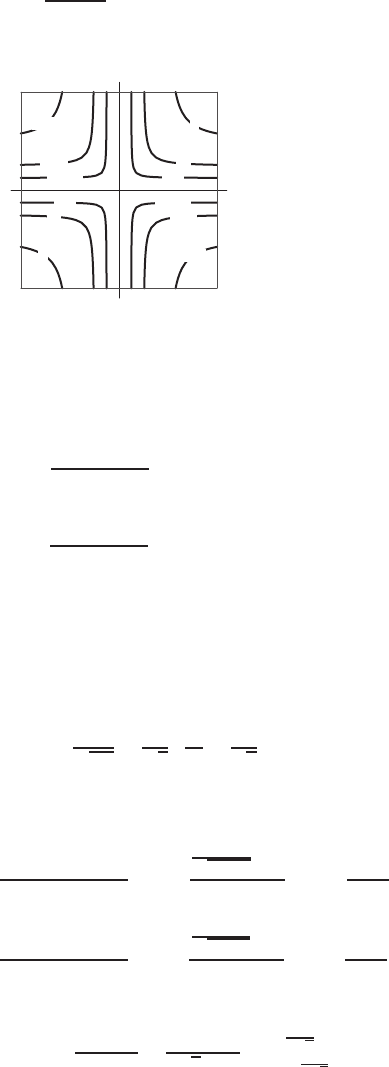
1354 Chapter Fourteen /SOLUTIONS
14. (a) The contour diagram for f(x, y) = xy/px2+y2is shown in Figure 14.47.
−2 2
−2
2
x
y
1
.5
.25
1
.5
.25
−1
−.5
−.25
−1
−.5
−.25
Figure 14.47
(b) By the chain rule, fis differentiable at all points (x, y)where x2+y26= 0, and so at all points (x, y)6= (0,0).
(c) The partial derivatives of fare given by
fx(x, y) = y3
(x2+y2)3/2,for (x, y)6= (0,0),
and
fy(x, y) = x3
(x2+y2)3/2,for (x, y)6= (0,0).
Both fxand fyare continuous at (x, y)6= (0,0).
(d) If fwere differentiable at (0,0), the chain rule would imply that the function
g(t) = nf(t, t), t 6= 0
0, t = 0
would be differentiable at t= 0. But
g(t) = t2
√2t2=1
√2·t2
|t|=1
√2· |t|,
which is not differentiable at t= 0. Hence, fis not differentiable at (0,0).
(e) The partial derivatives of fat (0,0) are given by
fx(0,0) = lim
x→0
f(x, 0) −f(0,0)
x= lim
x→0
x·0
√x2+02−0
x= lim
x→0
0−0
x= 0,
fy(0,0) = lim
y→0
f(0, y)−f(0,0)
y= lim
y→0
0·y
√02+y2−0
y= lim
y→0
0−0
y= 0.
The limit lim
(x,y)→(0,0) fx(x, y)does not exist since if we choose x=y=t,t6= 0, then
fx(x, y) = fx(t, t) = t3
(2t2)3/2=t3
2√2· |t|3=1
2√2, t > 0,
−1
2√2, t < 0.
Thus, fxis not continuous at (0,0). Similarly, fyis not continuous at (0,0).
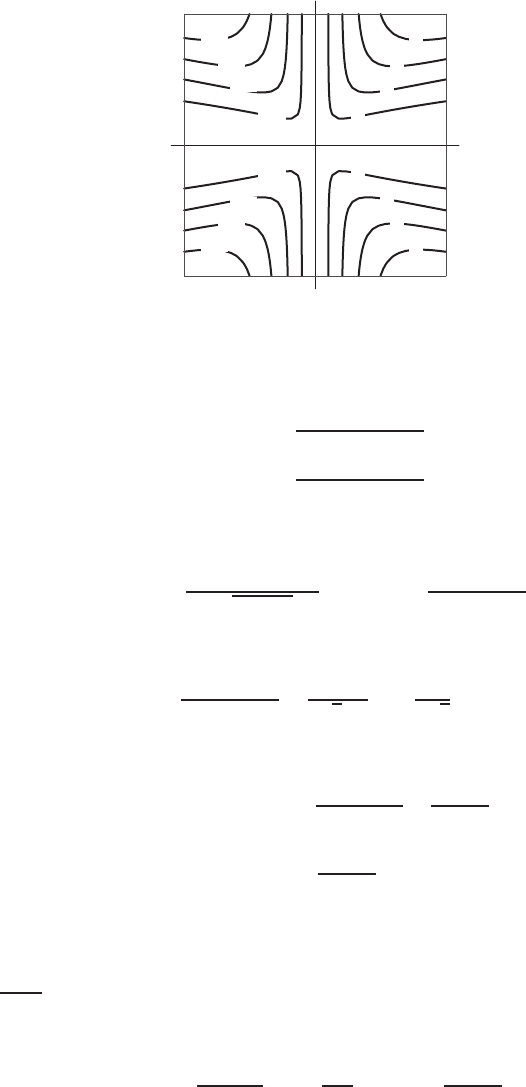
14.8 SOLUTIONS 1355
15. (a)
−2 2
−2
2
x
y
−.8
−.6
−.4
−.2
.8
.6
.4
.2
−.8
−.6
−.4
−.2
.8
.6
.4
.2
Figure 14.48
(b) fis differentiable at all (x, y)6= (0,0) as it is a rational function with nonvanishing denominator.
(c)
fx(0,0) = lim
x→0
f(x, 0) −f(0,0)
x= 0
fy(0,0) = lim
y→0
f(0, y)−f(0,0)
y= 0
(d) Let us use the definition. If fwere differentiable, the linear approximation of fwould be L(x, y) = mx +ny, where
m=fx(0,0) = 0 and n=fy(0,0) = 0. So let’s compute
lim
(x,y)→(0,0)
f(x, y)−L(x, y)
px2+y2= lim
(x,y)→(0,0)
xy2
(x2+y2)3/2.
This limit is not zero as, for x=y=t→0,t > 0,
xy2
(x2+y2)3/2=t3
2√2|t|3
t→0
t > 0
−→ 1
2√2.
Hence fis not differentiable at (0,0).
(e)
g(t) = f(x(t), y(t)) = ab2t3
(a2+b2)t2=ab2
a2+b2t
So
g′(0) = ab2
a2+b2.
(f) fx(0,0) ·x′(0) + fy(0,0) ·y′(0) = 0, as fx(0,0) = fy(0,0) = 0. Suppose the chain rule holds, then
g′(t) = fx(x(t), y(t)) ·x′(t) + fx(x(t), y(t))y′(t).
But g′(0) = ab2
a2+b2from part (e) and g′(0) 6= 0 since a6= 0 and b6= 0. Hence the chain rule does not hold. This
happens because fwas not differentiable at (0,0).
(g) If ~u =a
~
i+b~
j, then a2+b2= 1 as ~u is a unit vector. Thus,
f~u (0,0) = lim
t→0
f(at, bt)
t= lim
t→0
g(t)
t=g′(0) = a2b
a2+b2=a2b.
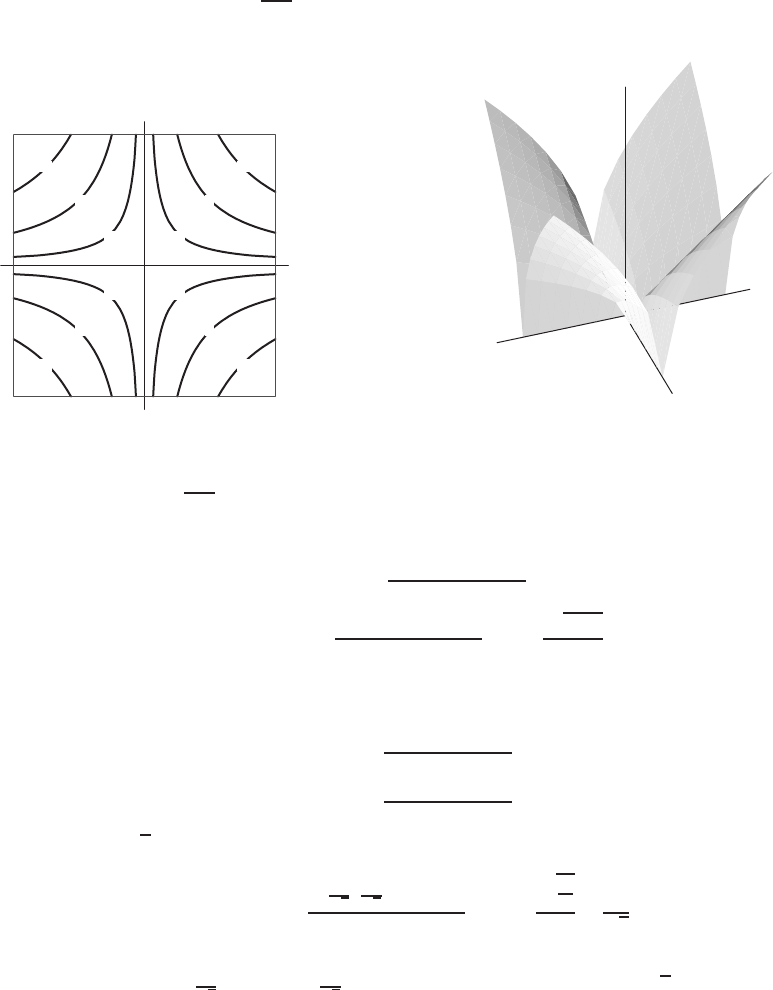
1356 Chapter Fourteen /SOLUTIONS
16. (a) The contour diagram of f(x, y) = p|xy|is shown in Figure 14.49.
−2 2
−2
2
x
y
.5
1
1.5
.5
1
1.5
.5
1
1.5
.5
1
1.5
Figure 14.49
x
y
z
Figure 14.50
(b) The graph of f(x, y) = p|xy|is shown in Figure 14.50.
(c) fis clearly differentiable at (x, y)where x6= 0 and y6= 0. So we need to look at points (x0,0),x06= 0 and (0, y0),
y06= 0. At (x0,0):
fx(x0,0) = lim
x→x0
f(x, 0) −f(x0,0)
x−x0
= 0
fy(x0,0) = lim
y→0
f(x0, y)−f(x0,0)
y= lim
y→0p|x0y|
y
which does not exist. So fis not differentiable at the points (x0,0),x06= 0. Similarly, fis not differentiable at the
points (0, y0),y06= 0.
(d)
fx(0,0) = lim
x→0
f(x, 0) −f(0,0)
x= 0
fy(0,0) = lim
y→0
f(0, y)−f(0,0)
y= 0
(e) Let ~u = (
~
i+~
j)/√2:
f~u (0,0) = lim
t→0+
f(t
√2,t
√2)−f(0,0)
t= lim
t→0+qt2
2
t=1
√2.
We know that ∇f(0,0) = ~
0because both partial derivatives are 0. But if fwere differentiable, f~u (0,0) =
∇f(0,0) ·~u =fx(0,0) ·1
√2+fy(0,0) ·1
√2= 0. But since, in fact, f~u (0,0) = 1/√2, we conclude that f
is not differentiable.
17. (a) The contour diagram of f(x, y) = xy2/(x2+y4)is shown in Figure 14.51.
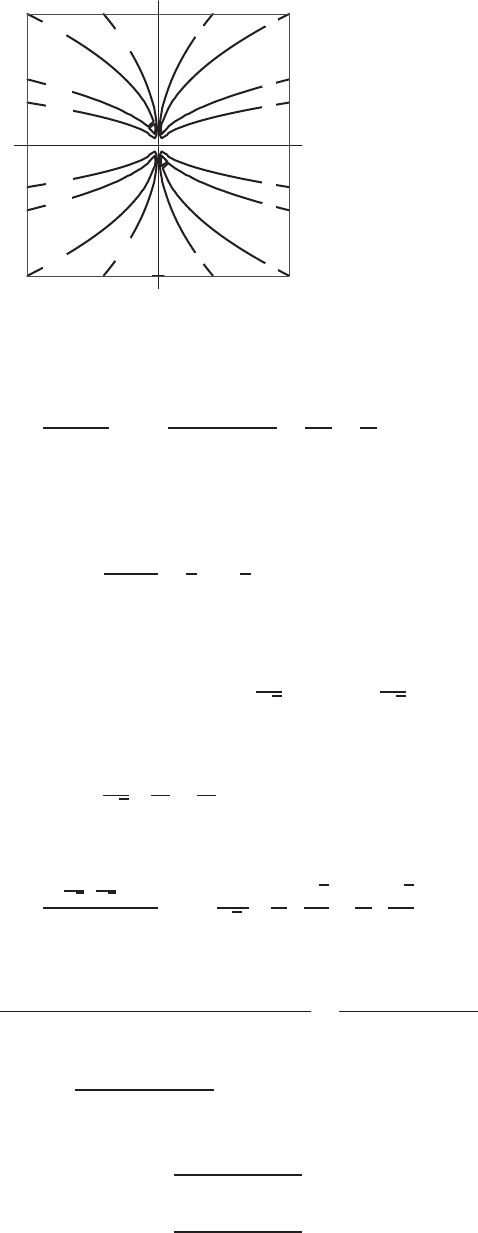
14.8 SOLUTIONS 1357
−2 2
−2
2
x
y
−.4
−.4
−.2
−.2
−.4
−.4
−.2
−.2
.4
.4
.2
.2
.4
.4
.2
.2
Figure 14.51
(b) Let ~u =a
~
i+b~
jbe the unit vector. Then
f~u (0,0) = lim
t→0
f(at, bt)
t= lim
t→0
ab2t3
t(a2t2+b4t4)=ab2
a2=b2
aif a6= 0
and
f~u (0,0) = 0 if a= 0.
(c) fis not continuous at (0,0). To see this let x=t2,y=t,t→0,t6= 0. Then
f(x, y) = t4
t4+t4=1
2
t→0
−→ 1
26=f(0,0) = 0.
So fis not differentiable at (0,0) either.
18. (a) If fwere differentiable at (0,0), then
f~u (0,0) = grad f(0,0) ·~u =fx(0,0) ·1
√2+fy(0,0) ·1
√2= 0
which contradict the information that f~u (0,0) = 3.
(b) Let
f(x, y) = (3
√2x2
y+y2
x, x 6= 0 and y6= 0,
0, x = 0 or y= 0.
Then fx(0,0) = 0,fy(0,0) = 0:
f~u (0,0) = lim
t→0
f(t
√2,t
√2)−0
t= lim
t→0
3
√2tt2
2·√2
t+t2
2·√2
t= 3.
19. (a) Differentiating gives
fx(x, y) = (3x2y3−y3)(x2+y2)−2x(x3y−xy3)
(x2+y2)2=x4y+ 4x2y3−y5
(x2+y2)2
similarly,
fy(x, y) = x5−4x3y2−xy4
(x2+y2)2for (x, y)6= (0,0).
(b) We find the partial derivatives at the origin by using the limit definition:
fx(0,0) = lim
x→0
f(x, 0) −f(0,0)
x= 0
fy(0,0) = lim
y→0
f(0, y)−f(0,0)
y= 0
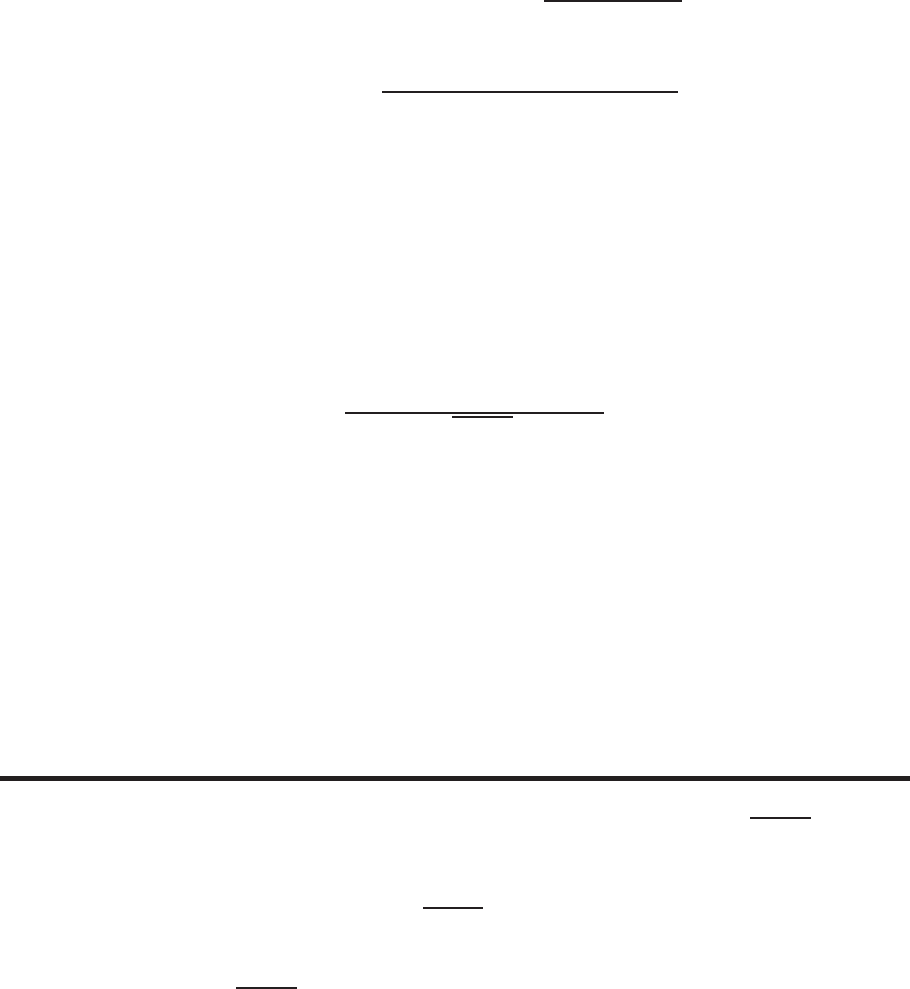
1358 Chapter Fourteen /SOLUTIONS
(c) Let’s compute:
lim
(x,y)→(0,0) fx(x, y) = lim
(x,y)→(0,0)
x4y+ 4x2y3−y5
(x2+y2)2.
Let’s switch to polar coordinates: x=rcos θ,y=rsin θ. Then (x, y)→(0,0) is equivalent to r→0. Therefore:
lim
(x,y)→(0,0) fx(x, y) = lim
r→0
r5(cos4θsin θ+ 4 cos4sin3θ−sin5θ)
r4= 0 = fx(0,0).
Similarly, lim(x,y)→(0,0) fy(x, y) = 0 = fy(0,0). So fxand fyare continuous.
(d) From part (c) fis differentiable at (0,0).
20. The fact that fis differentiable says that its graph is well approximated by a plane near (a, b). Since a plane is a graph of
continuous function, it is reasonable to expect fto be continuous too. To prove this, we have to show that
lim
(x,y)→(a,b)f(x, y) = f(a, b)or equivalently lim
h→0
k→0
f(a+h, b +k) = f(a, b).
Suppose fis differentiable at (a, b). Then there is a linear function
L(x, y) = f(a, b) + m(x−a) + n(y−b)
such that
lim
h→0
k→0
f(a+h, b +k)−L(a+h, b +k)
√h2+k2= 0.
If this limit is 0, then we also have
lim
h→0
k→0
f(a+h, b +k)−L(a+h, b +k) = 0.
Substituting for L(a+h, b +k), this gives
lim
h→0
k→0
(f(a+h, b +k)−f(a, b)−mh −nk) = 0.
So,
lim
h→0
k→0
f(a+h, b +k)−f(a, b) = 0.
Therefore fis continuous at (a, b).
Strengthen Your Understanding
21. The converse of this statement is true. If a function is differentiable at the origin, then it is continuous at the origin.
However, a function can be continuous and not differentiable at a point; for example, f(x, y) = px2+y2is continuous
but not differentiable at (0,0).
22. A counterexample is provided by
f(x, y) = (xy
x2+y2,(x, y)6= (0,0),
0,(x, y) = (0,0).
We have fx(0,0) = fy(0,0), but f(x, y)is not continuous or differentiable at (0,0).
23. The function f(x, y) = px2+y2whose graph is a cone with vertex at the origin is not differentiable at the origin.
24. Taking f(x, y) = |x−1|gives a function that is not differentiable on the line x= 1.
25. (a) Differentiable; point is at top of hemisphere.
(b) Not differentiable; hemisphere vertical at this point.
(c) Not differentiable; top point of cone with ellipse-shaped cross-section.
(d) Differentiable; point on side of cone.
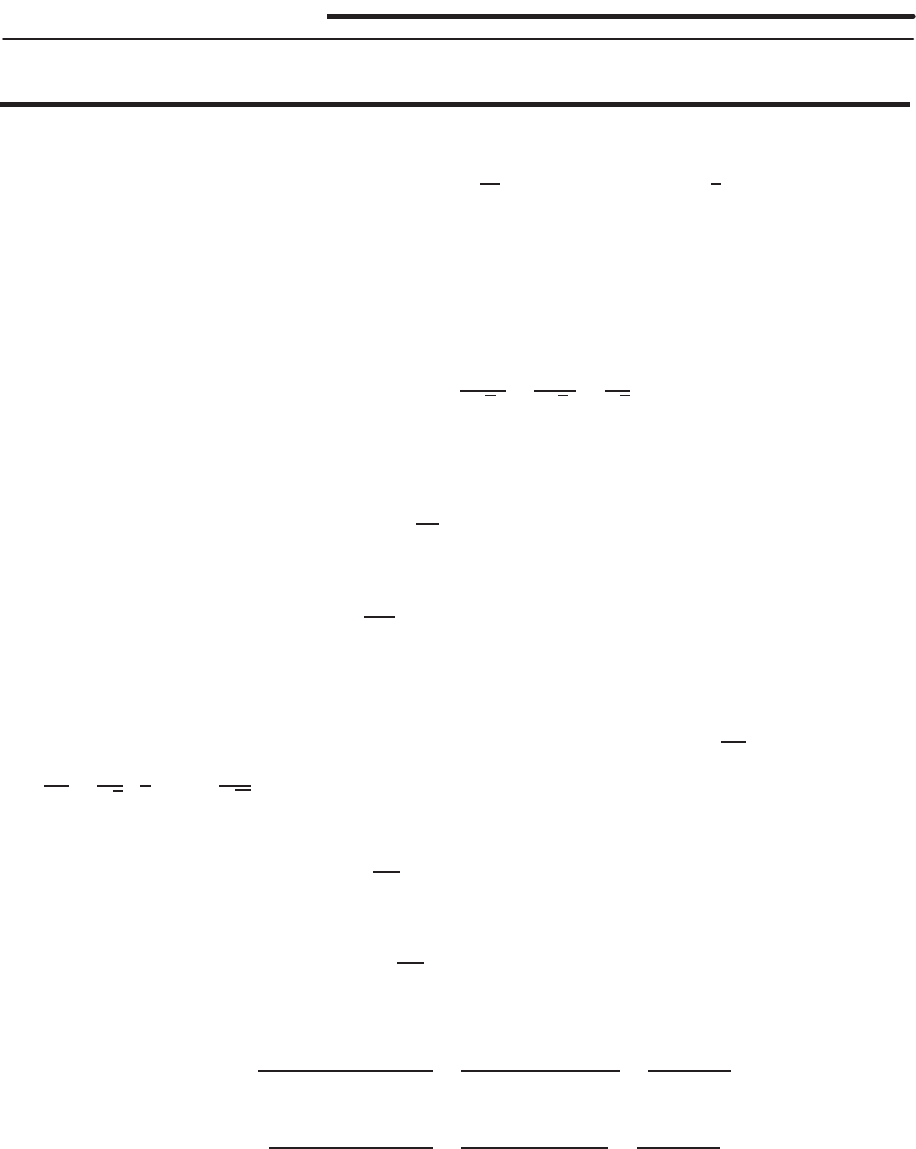
SOLUTIONS to Review Problems for Chapter Fourteen 1359
Solutions for Chapter 14 Review
Exercises
1. Vector. Taking the gradient and substituting x= 1,y= 2 gives
grad(x3e−y/2)(1,2)
=3x2e−y/2
~
i−x3
2e−y/2~
j(1,2)
= 3e−1
~
i−1
2e−1~
j .
2. Scalar. The gradient of f(x, y)at x= 1,y= 1 is given by
grad(x2y3)(1,1)
=2xy3
~
i+ 3x2y2~
j(1,1)
= 2
~
i+ 3~
j .
Thus the directional derivative is
f~u = (2
~
i+ 3~
j)·~
i+~
j
√2=2 + 3
√2=5
√2
3. Vector. grad((cos x)ey+z) = −(sin x)ey
~
i+ (cos x)ey~
j+~
k .
4. Scalar. Differentiating with respect to xusing the chain rule gives
∂f
∂x = 2xy2ex2y
so, differentiating again using the product rule, we have
∂2f
∂x2= 2y2ex2y+4x2y3ex2y.
5. Taking the derivative of fwith respect to xand treating yas a constant we get fx= 2xy + 3x2−7y6. To find fywe
take the derivative of fwith respect to yand treat xas a constant. Thus, fy=x2−42xy5.
6. First we distribute to get w= 6400πgh2−320πgh3.Taking the partial with respect to hwe get ∂w
∂h = 12,800πgh −960πgh2.
7. ∂T
∂l =2π
√g·1
2l−1/2=π
√lg .
8. To find the derivative of Bwith respect to t, note that the variable is only in the exponent. Thus,
∂B
∂t =P(1 + r)tln(1 + r).
To find the derivative of Bwith respect to r, note that this time the exponent is a constant, so we can use the power rule
to obtain ∂B
∂r =tP (1 + r)t−1.
9. For both partial derivatives we use the quotient rule. Thus,
fx=2xy(x2+y2)−x2y2x
(x2+y2)2=2x3y+ 2xy3−2x3y
(x2+y2)2=2xy3
(x2+y2)2,
and
fy=x2(x2+y2)−x2y2y
(x2+y2)2=x4+x2y2−2x2y2
(x2+y2)2=x4−x2y2
(x2+y2)2.

1360 Chapter Fourteen /SOLUTIONS
10. To find the derivative of Fwith respect to rwe first rewrite F=Gµmy(r2+y2)−3/2and then use the chain rule. Thus,
∂F
∂r =Gµmy −3
2(r2+y2)−5/2·2r.
To find the derivative of Fwith respect to ywe use the quotient rule to obtain
∂F
∂y =Gµm(r2+y2)3/2−Gµmy(3
2)(r2+y2)1/2·2y
(r2+y2)3.
11. ∂f
∂p =∂
∂p ep/q=1
qep/q.
∂f
∂q =∂
∂q ep/q =∂
∂q hepq−1i= (−pq−2)epq−1=−p
q2ep/q.
12. zx=−sin x,zx(2,3) = −sin 2 ≈ −0.9
13. Since we take the derivative with respect to N, we use the power rule to obtain fN=cαNα−1Vβ.
14. This function is symmetric with respect to xand y. Therefore the answers look very similar. Using the chain rule we have
fx=2(x−a)
2p(x−a)2+ (y−b)2=(x−a)
p(x−a)2+ (y−b)2
and
fy=2(y−b)
2p(x−a)2+ (y−b)2=(y−b)
p(x−a)2+ (y−b)2.
15. Using the chain rule
∂
∂ω tan √ωx=1
cos2√ωx·1
2(ωx)−1/2·x=x
2√ωx cos2√ωx.
16. ∂y
∂t = cos(ct −5x)c=ccos(ct −5x)
17. Using the quotient rule
zy=(15xy −8)(21x2y6−2y)−15x(3x2y7−y2)
(15xy −8)2
=315x3y7−168x2y6−30xy2+ 16y−45x3y7+ 15xy2
(15xy −8)2
=270x3y7−168x2y6−15xy2+ 16y
(15xy −8)2
18. Using the quotient rule,
∂α
∂β =(2yβ + 5)exβ−3x−2yexβ−3
(2yβ + 5)2=[(2yβ + 5)x−2y]exβ−3
(2yβ + 5)2=(5x−2y+ 2xyβ)exβ−3
(2yβ + 5)2
19. Using the chain rule,
∂
∂w (p2πxyw −13x7y3v) = 1
2(2πxyw −13x7y3v)−1/2(2πxy −0)
=πxy
p2πxyw −13x7y3v.

SOLUTIONS to Review Problems for Chapter Fourteen 1361
20. Using the product and chain rules,
∂
∂λ x2yλ−3λ5
√λ2−3λ+ 5
=(x2y−15λ4)pλ2−3λ+ 5 −(2λ−3)(x2yλ −3λ5)
2√λ2−3λ+ 5 1
λ2−3λ+ 5
=(x2y−15λ4)·2(λ2−3λ+ 5) −(2λ−3)(x2yλ −3λ5)
2(λ2−3λ+ 5)√λ2−3λ+ 5
=x2y[2(λ2−3λ+ 5) −(2λ−3)λ]−15λ4·2(λ2−3λ+ 5) + (2λ−3) ·3λ5
2(λ2−3λ+ 5)√λ2−3λ+ 5
=x2y(−3λ+ 10) −3λ4(8λ2−27λ+ 50)
2(λ2−3λ+ 5)√λ2−3λ+ 5
21. Using the chain rule and the quotient rule,
∂
∂w x2yw −xy3w7
w−1−7/2
=−7
2x2yw−xy3w7
w−1−9/2(w−1)(x2y−7xy3w6)−(x2yw −xy3w7)(1)
(w−1)2
=−7
2w−1
x2yw −xy3w7−9/2(w−1)(x2y−7xy3w6)−(x2yw −xy3w7)
(w−1)2
=7
2w−1
x2yw −xy3w7−9/2
·x2y+ 6xy3w7−7xy3w6
(w−1)2
22. To find the partial derivative with respect to xwe treat yand aas constants: ∂
∂x (excos(xy) + ay2) = excos(xy) + ex·
(−sin(xy)) ·y.
To find the partial derivative with respect to ywe treat xand aas constants: ∂
∂y (excos(xy)+ay2) = ex·(−sin(xy))·
x+ 2ay.
To find the partial derivative with respect to awe treat xand yas constants: ∂
∂a (excos(xy) + ay2) = y2.
23. ∂f0
∂L =1
2π(−1
2)(LC)−3/2C=−1
4π
C
LC√LC =−1
4πL√LC
24. The first order partial derivative fxis
fx=−x(x2+y2)−3/2
Thus the second order partials are
fxx =−(x2+y2)−3/2+ 3x2(x2+y2)−5/2= (2x2−y2)(x2+y2)−5/2
and
fxy = 3xy(x2+y2)−5/2.
25. The first order partial derivatives are
ux=exsin y, uy=excos y.
Thus the second order partials are
uxx =exsin y, uyy =−exsin y.
26. The first order partial derivative Vris
Vr= 2πrh.
Thus the second order partials are
Vrr = 2πh, Vrh = 2πr.
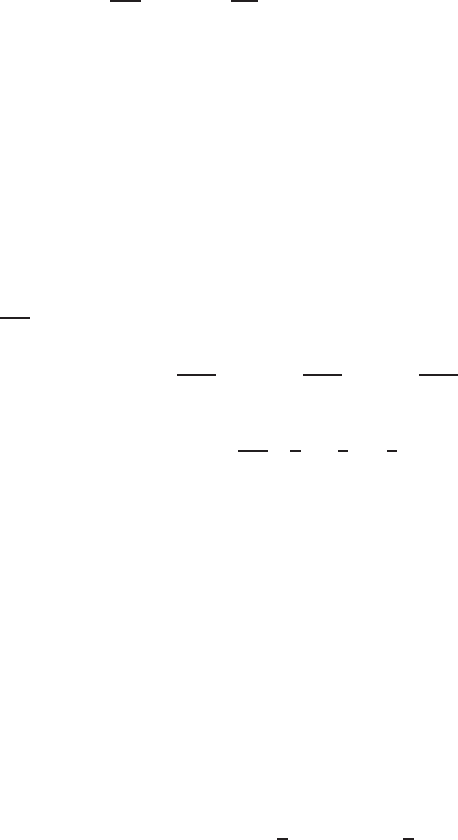
1362 Chapter Fourteen /SOLUTIONS
27. The first order partials are
fx= cos(x−2y), fy=−2 cos(x−2y).
The second order partials fxx and fyx are
fxx =−sin(x−2y), fyx = 2 sin(x−2y).
The third order partials are then
fxxy = 2 cos(x−2y), fyxx = 2 cos(x−2y).
Note that these are equal as we would expect, since the order does not matter for higher order partial derivatives of smooth
functions.
28. We have
∂2
∂x2(eax−bt) + ∂2
∂t2(eax−bt) = (a2+b2)eax−bt.
29. Since fx= 2x,fy= 2y+ 3y2and fz= 0, we have
grad f= 2x
~
i+ (2y+ 3y2)~
j .
30. Since the partial derivatives are
fx= 3x2−yz, fy=−xz, fz= 3z2−xy,
we have
∇f= (3x2−yz)
~
i−xz~
j+ (3z2−xy)~
k .
31. Since f(x, y, z) = 1
xyz , we have
fx=−1
x2yz , fy=−1
xy2zfz=−1
xyz2,
we have
grad f=−1
xyz 1
x~
i+1
y~
j+1
z~
k.
32. Since the partial derivatives are
fx=−ycos(y2−xy)and fy= (2y−x) cos(y2−xy),
we have
∇f= cos(y2−xy)(−y~
i+ (2y−x)~
j).
33. Since the partial derivatives are
zx= (2x) cos (x2+y2),and zy= (2y) cos (x2+y2),
∇z= 2xcos (x2+y2)
~
i+ 2ycos (x2+y2)~
j .
34. Since f(x, y, z) = xey+ ln x+ ln z, we have fx=ey+ 1/x,fy=xey,fz= 1/z, so
grad f=ey+1
x~
i+xey~
j+1
z~
k .
35. Since fx= 2xcos(x2+y2+z2),fy= 2ycos(x2+y2+z2)and fz= 2zcos(x2+y2+z2), we have
grad f= 2xcos(x2+y2+z2)
~
i+ 2ycos(x2+y2+z2)~
j+ 2zcos(x2+y2+z2)~
k .
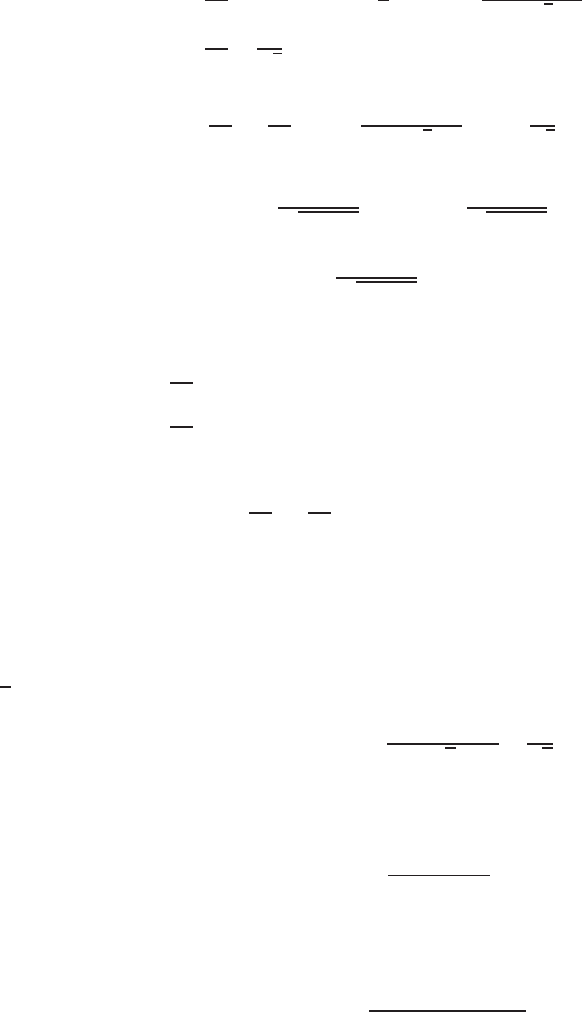
SOLUTIONS to Review Problems for Chapter Fourteen 1363
36. Since the partial derivatives are
fρ= sin φcos θ, fφ=ρcos φcos θ, fθ=−ρsin φsin θ,
we have
∇f= sin φcos θ
~
i+ρcos φcos θ~
j−ρsin φsin θ~
k .
37. Since the partial derivatives are
∂f
∂s = (t2−2t+ 4)(−1
2)s−3/2=−(t2−2t+ 4)
2s√s
∂f
∂t =1
√s(2t−2)
we have
grad f=∂f
∂s~
i+∂f
∂t ~
j=−(t2−2t+4)
2s√s~
i+1
√s(2t−2)~
j.
38. Since the partial derivatives are
fx=x
px2+y2and fy=y
px2+y2,
we have
∇f=1
px2+y2(x
~
i+y~
j).
39. Since the partial derivatives are
∂f
∂x = cos(xy)·(y)−sin(xy)·(y) = y[cos(xy)−sin(xy)]
∂f
∂y = cos(xy)·(x)−sin(xy)·(x) = x[cos(xy)−sin(xy)]
we have
grad f=∂f
∂x~
i+∂f
∂y~
j
=y[cos(xy)−sin(xy)]
~
i+x[cos(xy)−sin(xy)]~
j .
40. We have fx= 2x,fy= 0 and fz= 0.Thus grad f= 2x
~
iand grad f(0,0,0) = ~
0.
41. We have fx= 2xz,fy= 0 and fz=x2.Thus grad f= 2xz~
i+x2~
kand grad f(1,1,1) = 2
~
i+~
k .
42. We have grad f= 3x2
~
i−3y2~
j, so grad f(2,−1) = 12
~
i−3~
j. A unit vector in the direction we want is ~u =
(1/√2)(
~
i−~
j). Therefore, the directional derivative is
grad f(−2,1) ·~u =12 ·1−3(−1)
√2=15
√2.
43. We have grad f=ey
~
i+xey~
j, so grad f(3,0) = ~
i+3~
j. A unit vector in the direction we want is ~u = (1/5)(4
~
i−3~
j).
Therefore, the directional derivative is
grad f(3,0) ·~u =1·4 + 3(−3)
5=−1.
44. We have grad f= 2x
~
i+ 2y~
j−2z~
k, so grad f(2,3,4) = 4
~
i+ 6~
j−8~
k. A unit vector in the direction we want is
~u = (1/3)(2
~
i−2~
j+~
k). Therefore, the directional derivative is
grad f(2,3,4) ·~u =4·2 + 6(−2) −8·1
3=−4.
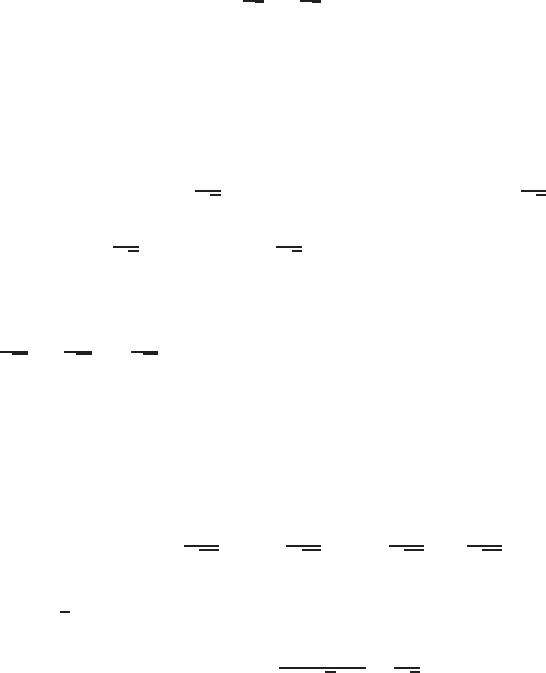
1364 Chapter Fourteen /SOLUTIONS
45. The unit vector ~u in the direction of ~v =~
i−~
kis ~u =1
√2~
i−1
√2~
k. We have
fx(x, y, z) = 6xy2,and fx(−1,0,4) = 0
fy(x, y, z) = 6x2y+ 2z, and fy(−1,0,4) = 8
fz(x, y, z) = 2y, and fz(−1,0,4) = 0.
So,
f~u (−1,0,4) = fx(−1,0,4) 1
√2+fy(−1,0,4)(0) + fz(−1,0,4) −1
√2
= 0 1
√2+ 8(0) + 0 −1
√2
= 0.
46. The unit vector ~u =−1
√19~
i+3
√19~
j+3
√19 ~
kis in the direction of ~v =−~
i+ 3~
j+ 3~
k. We have
fx(x, y, z) = 6xy2,and fx(−1,0,4) = 0
fy(x, y, z) = 6x2y+ 2z, and fy(−1,0,4) = 8
fz(x, y, z) = 2y, and fz(−1,0,4) = 0.
So,
f~u (−1,0,4) = 0 −1
√19 + 8 3
√19 + 0 3
√19 =24
√19 .
47. We have grad f= (ex+zcos y)
~
i−(ex+zsin y)~
j+ (ex+zcos y)~
k, so grad f(1,0,−1) = ~
i+~
k. A unit vector in the
direction we want is ~u = (1/√3)(
~
i+~
j+~
k). Therefore, the directional derivative is
grad f(1,0,−1) ·~u =1·1 + 1 ·1
√3=2
√3.
48. The given curve is the contour for f(x, y) = x2−y2passing through the point (2,1). Thus a normal vector is grad f(2,1).
We have grad f= 2x
~
i−2y~
j, so a normal vector is grad f(2,1) = 4
~
i−2~
j.
49. The given surface is the level surface for f(x, y, z) = xy +xz +yz passing through the point (1,2,3). Thus a normal
vector is grad f(1,2,3). We have grad f= (y+z)
~
i+ (x+z)~
j+ (x+y)~
k, so a normal vector is grad f(1,2,3) =
5
~
i+ 4~
j+ 3~
k.
50. The given surface is the level surface for f(x, y, z) = z2−2xyz −x2−y2passing through the point (1,2,−1). Thus a
normal vector is grad f(1,2,−1). We have
grad f= (−2x−2yz)
~
i+ (−2y−2xz)~
j+ (2z−2xy)~
k ,
so a normal vector is grad f(1,2,−1) = 2
~
i−2~
j−6~
k.
51. Let f(x, y, z) = z2−4x2−3y2so that the surface (a hyperboloid) is the level surface f(x, y, x) = 9. Since
grad f=−8x
~
i−6y~
j+ 2z~
k
we have
grad f(1,1,4) = −8
~
i−6~
j+ 8~
k .
Thus an equation of the tangent plane at (1,1,4) is
−8(x−1) −6(y+ 6) + 8(z−4) = 0
so
−4x−3y+ 4z= 9.

SOLUTIONS to Review Problems for Chapter Fourteen 1365
52. Let f(x, y, z) = x3−2y2+zso that the given surface is the level surface f(x, y, z) = 0. Since
grad f= 3x2
~
i−4y~
j+~
k
we have
grad f(1,0,−1) = 3
~
i+~
k .
Thus an equation of the tangent plane at (1,0,−1) is
3(x−1) + 0(y−0) + 1(z−(−1)) = 0
or
3x+z= 2.
53. Let f(x, y, z) = z−1/(xy). We have
grad f=1
x2y~
i+1
xy2~
j+~
k .
Thus
grad f(1,1,1) = ~
i+~
j+~
k .
The tangent plane to the level surface at (1,1,1) is
(x−1) + (y−1) + (z−1) = 0
or
x+y+z= 3.
54. The first and second derivatives are
fx= 2xy2−5y3
fy= 2x2y−15xy2
fxx = 2y2
fxy = 4xy −15y2
fyx = 4xy −15y2
fyy = 2x2−30xy.
55. Using the chain rule we see:
dz
dt =∂z
∂x
dx
dt +∂z
∂y
dy
dt
= sin y(cos t) + x(cos y) (−sin t)
= sin(cos t) cos t−sin tcos(cos t) sin t
= sin(cos t) cos t−sin2tcos(cos t).
We can also solve the problem using one variable methods:
z= sin tsin(cos t)
dz
dt =d
dt (sin tsin(cos t))
=dsin t
dt sin(cos t) + sin td(sin(cos t))
dt
= cos tsin(cos t) + sin tcos(cos t)(−sin t)
= cos tsin(cos t)−sin2tcos(cos t).

1366 Chapter Fourteen /SOLUTIONS
56. This is a case where substituting is easier:
z= sin((2t)2+ (t2)2)
= sin(4t2+t4)
dz
dt = (8t+ 4t3) cos(4t2+t4).
If you use the chain rule the solution is:
dz
dt =∂z
∂x
dx
dt +∂z
∂y
dy
dt
= 2xcos(x2+y2)(2) + 2ycos(x2+y2)(2t)
= 2(2t) cos(4t2+t4)(2) + 2(t2) cos(4t2+t4)(2t)
= (2 ·2t·2 + 2 ·t2·2t) cos(4t2+t4)
= (8t+ 4t3) cos(4t2+t4).
57. Substituting into the chain rule gives
dz
dt =∂z
∂x
dx
dt +∂z
∂y
dy
dt
= 2(x2+y)·2x·2 + 2(x2+y)·2t
= (x2+y)(8x+ 4t)
= ((2t)2+t2)(8 ·2t+ 4t)
= (4t2+t2)(20t)
= 5t2(20t)
= 100t3.
58. Substituting into the chain rule gives
dz
dt =∂z
∂x
dx
dt +∂z
∂y
dy
dt
= ((x+y)ex+ex)·(2t) + ex·(−2t)
= (t2+ (1 −t2))et2·(2t) + et2·(2t) + et2·(−2t)
= 2tet2(t2+ 1 −t2+ 2t−2t)
= 2tet2.
This is a case where substituting is much easier:
z= (t2+ (1 −t2))et2
=et2
dz
dt = 2tet2.
59. Using the chain rule we see:
dz
dt =∂z
∂x
dx
dt +∂z
∂y
dy
dt
=1
x·3t2+1
y·2t
=1
t3·3t2+1
t2+ 1 ·2t
=3
t+2t
t2+ 1 .
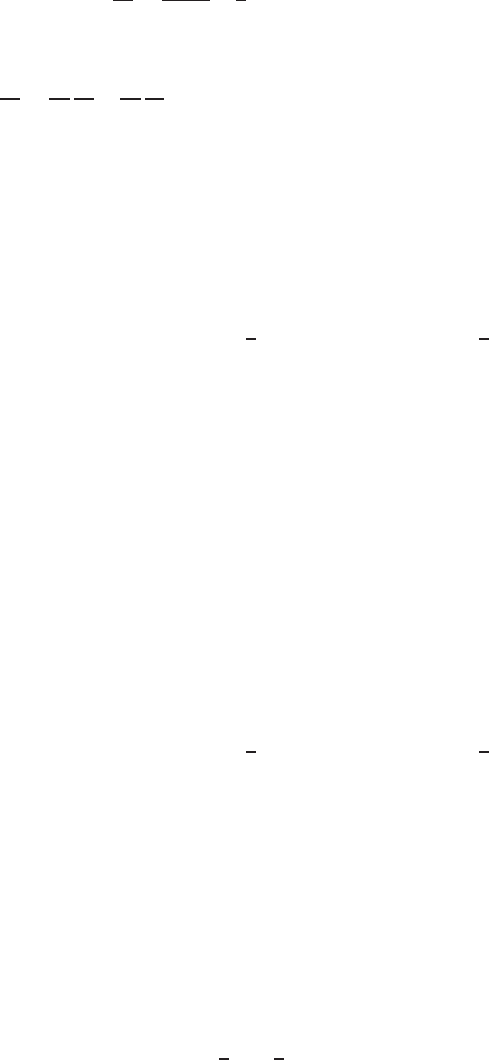
SOLUTIONS to Review Problems for Chapter Fourteen 1367
This problem can also be solved using one variable methods.
z= ln(t2+ 1) + ln t3
= ln(t2+ 1) + 3 ln t
dz
dt =2t
t2+ 1 +3
t.
60. Substituting into the chain rule gives
dz
dt =∂z
∂p
dp
dt +∂z
∂q
dq
dt
=qcos(pq)·cos t+pcos(pq)·(−sin(t2)·2t)
= cos(pq)cos t2cos t−2tsin tsin(t2)
= cos(sin tcos t2)cos t2cos t−2tsin tsin(t2).
61. The quadratic Taylor expansion about (0,0) is given by
f(x, y)≈Q(x, y) = f(0,0) + fx(0,0)x+fy(0,0)y+1
2fxx(0,0)x2+fxy (0,0)xy +1
2fyy(0,0)y2.
First we find all the relevant derivatives
f(x, y) = (x+ 1)3(y+ 2)
fx(x, y) = 3(x+ 1)2(y+ 2)
fy(x, y) = (x+ 1)3
fxx(x, y) = 6(x+ 1)(y+ 2)
fyy(x, y) = 0
fxy(x, y) = 3(x+ 1)2
Now we evaluate each of these derivatives at (0,0) and substitute into the formula to get as our final answer:
Q(x, y) = 2 + 6x+y+ 6x2+ 3xy
Notice this is the same as what you get if you expand (x+ 1)3(y+ 2) and keep only the terms of degree 2or less.
62. The quadratic Taylor expansion about (0,0) is given by
f(x, y)≈Q(x, y) = f(0,0) + fx(0,0)x+fy(0,0)y+1
2fxx(0,0)x2+fxy (0,0)xy +1
2fyy(0,0)y2.
First we find all the relevant derivatives
f(x, y) = cos xcos 3y
fx(x, y) = −sin xcos 3y
fy(x, y) = −3 cos xsin 3y
fxx(x, y) = −cos xcos 3y
fyy(x, y) = −9 cos xcos 3y
fxy (x, y) = 3 sin xsin 3y
Now we evaluate each of these derivatives at (0,0) and substitute into the formula to get as our final answer:
Q(x, y) = 1 −1
2x2−9
2y2
Notice this is the same as what you get if you multiply together the quadratic approximations for cos xand cos 3yand
then keep only the terms of degree 2or less.
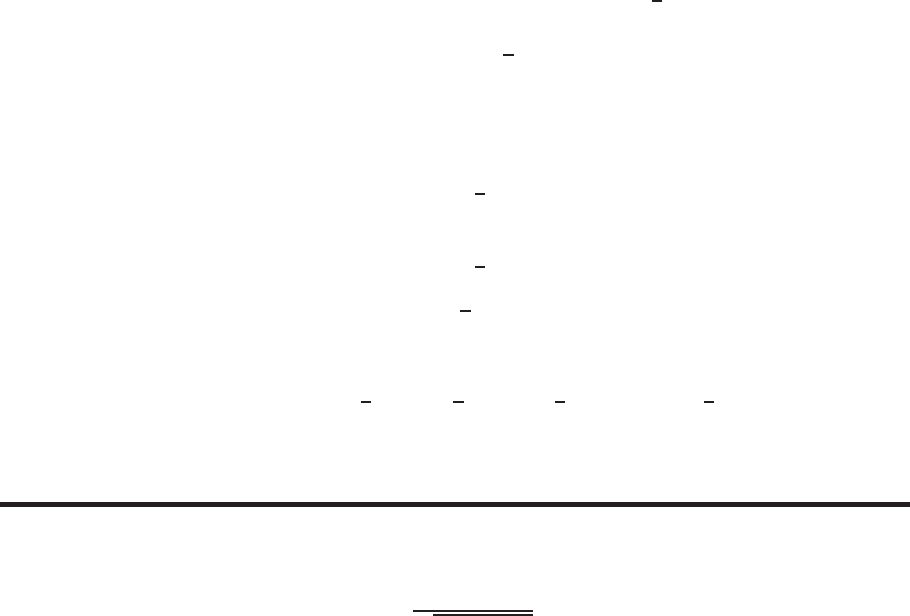
1368 Chapter Fourteen /SOLUTIONS
63. The quadratic Taylor expansion about (3,5) is given by
f(x, y)≈Q(x, y) = f(3,5) + fx(3,5)(x−3) + fy(3,5)(y−5) + 1
2fxx(3,5)(x−3)2+
fxy (3,5)(x−3)(y−5) + 1
2fyy(3,5)(y−5)2.
First we find all the relevant derivatives
f(x, y) = (2x−y)1/2
fx(x, y) = (2x−y)−1/2
fy(x, y) = −1
2(2x−y)−1/2
fxx(x, y) = −(2x−y)−3/2
fyy(x, y) = −1
4(2x−y)−3/2
fxy(x, y) = 1
2(2x−y)−3/2
Now we evaluate each of these derivatives at (3,5) and substitute into the formula to get as our final answer:
Q(x, y) = 1 + (x−3) −1
2(y−5) −1
2(x−3)2+1
2(x−3)(y−5) −1
8(y−5)2.
Problems
64. The gradient of (a) is 2x
~
i+ 2y~
j+ 2z~
k, which points radially outward from the origin and increases in magnitude, so
(a) goes with (IV).
The gradient of (b) is
x
~
i+y~
j+z~
k
px2+y2+z2,
which points radially outward and has magnitude 1. Thus (b) goes with (V).
The gradient of (c) is 3
~
i+ 4~
j, which is constant and parallel to the xy-plane, so (c) goes with (I).
The gradient of (d) is 3
~
i+ 4~
k, which is constant and parallel to xz-plane, so (d) goes with (II).
65. (a) Let f(x, y, z) = 2x2−2xy2+az so that the given surface is the level surface f(x, y, z) = a. Since
grad f= (4x−2y2)
~
i−4xy~
j+a~
k
we have
grad f(1,1,1) = 2
~
i−4~
j+a~
k .
Thus an equation of the tangent plane at (1,1,1) is
2(x−1) −4(y−1) + a(z−1) = 0
or
2x−4y+az =a−2.
(b) Substituting x= 0,y= 0,z= 0 into the equation for the tangent plane in part (a) we have 0 = a−2. The tangent
plane passes through the origin if a= 2.
66. (a) This means you must pay a mortgage payment of $1090.08/month if you have borrowed a total of $92,000 at an
interest rate of 14%, on a 30-year mortgage.
(b) This means that the rate of change of the monthly payment with respect to the interest rate is $72.82; i.e., your
monthly payment will go up by approximately $72.82 for one percentage point increase in the interest rate for the
$92,000 borrowed under a 30-year mortgage.
(c) It should be positive, because the monthly payments will increase if the total amount borrowed is increased.
(d) It should be negative, because as you increase the number of years in which to pay the mortgage, you should have to
pay less each month.
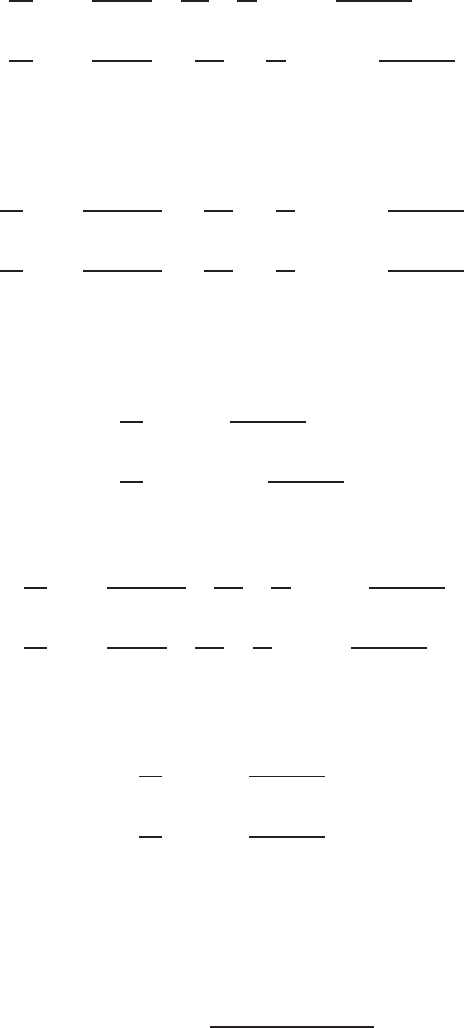
SOLUTIONS to Review Problems for Chapter Fourteen 1369
67. (a) At Q, R, we have fx<0because fdecreases as we move in the x-direction.
(b) At Q, P , we have fy>0because fincreases as we move in the y-direction.
(c) At all four points, P, Q, R, S, we have fxx >0, because fxis increasing as we move in the x-direction. (At P, S,
we see that fxis positive and getting larger; at Q, R, we see that fxis negative and getting less negative.)
(d) At all four points, P, Q, R, S, we have fyy >0, so there are none with fyy <0. The reasoning is similar to part (c).
68. Estimating from the contour diagram, using positive increments for ∆xand ∆y, we have, for point A,
∂n
∂x (A)≈1.5−1
67 −59 =1/2
8=1
16 ≈0.06 foxes/km2
km
∂n
∂y (A)≈0.5−1
60 −51 =−1/2
9=−1
18 ≈ −0.06 foxes/km2
km .
So, from point Athe fox population density increases as we move eastward. The population density decreases as we move
north from A.
At point B,
∂n
∂x (B)≈0.75 −1
135 −115 =−1/4
20 =−1
80 ≈ −0.01 foxes/km2
km
∂n
∂y (B)≈0.5−1
120 −110 =−1/2
10 =−1
20 ≈ −0.05 foxes/km2
km .
So, fox population density decreases as we move both east and north of B. However, notice that the partial derivative
∂n/∂x at Bis smaller in magnitude than the others. Indeed if we had taken a negative ∆xwe would have obtained an
estimate of the opposite sign. This suggests that better estimates forBare
∂n
∂x (B)≈0foxes/km2
km
∂n
∂y (B)≈ −0.05 foxes/km2
km .
At point C,
∂n
∂x (C)≈2−1.5
135 −115 =1/2
20 =1
40 ≈0.02 foxes/km2
km
∂n
∂y (C)≈2−1.5
80 −55 =1/2
25 =1
50 ≈0.02 foxes/km2
km .
So, the fox population density increases as we move east and north of C. Again, if these estimates were made using
negative values for ∆xand ∆ywe would have had estimates of the opposite sign. Thus, better estimates are
∂n
∂x (C)≈0foxes/km2
km
∂n
∂y (C)≈0foxes/km2
km .
69. The derivative ∂c/∂x =bis the rate of change of the cost of producing one unit of the product with respect to the amount
of labor used (in man hours) when the amount of raw material used stays the same. Thus ∂c/∂x =brepresents the hourly
wage.
70. (a) The difference quotient for approximating fu(u, v)is given by
fu(u, v)≈f(u+h, v)−f(u, v)
h.

1370 Chapter Fourteen /SOLUTIONS
Putting (u, v) = (1,3) and h= 0.001, the difference quotient is
fu(1,3) ≈1.001(1.0012+ 32)3/2−1(12+ 32)3/2
0.001
≈31.6639 −31.6228
0.001 ≈0.0411
0.001 ≈41.1
(b) Using the derivative formulas
fu=∂f
∂u = (u2+v2)3/2+ 3u2(u2+v2)1/2= (u2+v2)1/2(4u2+v2)
so
fu(1,3) = (12+ 32)1/2·(4 ·12+ 32)≈41.11
We see that the approximation in part (a) was reasonable.
71. Substituting for G,M,m, and r, we have
F=GMm
r2=(6.67 ·10−11)(6 ·1024 )(70)
(6.4·106)2= 684 newtons.
The gravitational force on this person is about 684 newtons.
Differentiating gives
∂F
∂m =GM
r2= 9.77 newtons/kg
and ∂F
∂r =−2GMm
r3=−0.000214 newtons/meter.
These partial derivatives tell us that the gravitational force increases by about 9.77 newtons for an increase of 1 kg in
the mass, and the gravitational force decreases by about 0.000214 newtons if the distance from the center of the earth
increases by 1 meter.
72. (a) The area of a circle of radius ris given by
A=πr2
and the perimeter is
L= 2πr.
Thus we get
r=L
2π
and
A=πL
2π2
=L2π
4π2=L2
4π.
Thus we get
π=L2
4A.
(b) We will treat πas a function of Land A.
dπ =∂π
∂L dL +∂π
∂A dA =2L
4AdL −L2
4A2dA.
If Lis in error by a factor λ, then ∆L=λL, and if Ais in error by a factor µ, then ∆A=µA. Therefore,
∆π≈2L
4A∆L−L2
4A2∆A
=2L
4AλL −L2
4A2µA
=2λL2
4A−µL2
4A= (2λ−µ)L2
4A= (2λ−µ)π,
so πis in error by a factor of 2λ−µ.

SOLUTIONS to Review Problems for Chapter Fourteen 1371
73. (a) The linear approximation
∆F≈Fx∆x+Fy∆y
gives, for x= 400 and y= 50,
∆F≈40x−1/3y1/3∆x+ 20x2/3y−2/3∆y= 20∆x+ 80∆y.
The company increases its skilled labor by 5 hours, so ∆y= 5. Since output is to remain constant, we have ∆F= 0.
Making these substitutions in the linear approximation we get
20∆x+ 80 ·5 = 0,so ∆x=−20.
With 5 additional hours per day of skilled labor and 20 fewer hours per day of unskilled labor, the company can
keep its output at the current level.
(b) When x= 400 and y= 50, output is given by
F(400,50) = 60 ·4002/3·501/3= 12,000
When yis increased to 55, if output remains constant, we have
12,000 = 60 ·x2/3·551/3.
Solving for xgives
x=12000
60 ·551/33/2
=381.385 hours per day.
Thus, the number of hours of unskilled labor is reduced by 400 −381.385 = 18.615 hours per day.
74. (a) If the volume is held constant, ∆V= 0, so ∆U≈27.32∆T. Thus the energy increases if the temperature increases.
(b) If the temperature is held constant, then ∆T= 0, so ∆U≈840∆V. Thus the energy increases if the volume
increases (yes, it sounds bizarre, but remember the temperature is being held constant).
(c) First, we convert 100 cm3to 0.0001 m3. Now, using the differential approximation,
∆U≈840 ∆V+ 27.32 ∆T
= (840)(−0.0001) + (27.32)(2)
=−0.084 + 54.64 ≈55 joules.
75. Since grad f=fx
~
i+fy~
j, we see that fxis given by the ~
i-component of grad fand fyis given by the ~
j-component
of grad f. Also, fxx is the rate of change of fxin the x-direction and fyy is the rate of change of fyin the y-direction.
(a) At P, S, we have fx>0.
(b) At R, S, we have fy<0.
(c) At all four points, P, Q, R, S, we have fxx >0because fxincreases as we move in the x-direction. (At P, S, we
see fxis positive and gets larger; at Q, R, we see fxis negative and getting less negative.)
(d) No points. At P, Q, the value of fyis positive and increasing as yincreases. At R, S, the value of fyis negative and
increasing (getting less negative) as yincreases.
76. The directional derivative is approximately the change in z(as we move in direction ~v ) divided by the horizontal change
in position. The directional derivative is f~
i≈2−1
4−1=1
3≈0.3.
77. The directional derivative is approximately the change in z(as we move in direction ~v ) divided by the horizontal change
in position. The directional derivative is f~
j≈2−1
4−1=1
3≈0.3.
78. The directional derivative is approximately the change in z(as we move in direction ~v ) divided by the horizontal change
in position. In the direction of ~v , the directional derivative ≈2−1
k~
i+~
jk=1
√2≈0.7.
79. The directional derivative is approximately the change in z(as we move in direction ~v ) divided by the horizontal change
in position. In the direction of ~v , the directional derivative ≈3.2−2
k~
i+~
jk=1.2
√2≈0.8.
80. The directional derivative is approximately the change in z(as we move in direction ~v ) divided by the horizontal
change in position. In the direction of ~v we go from point (3,3) to point (1,4). We have the directional derivative
≈2−3
k − 2
~
i+~
jk=−1
√5≈ −0.4.
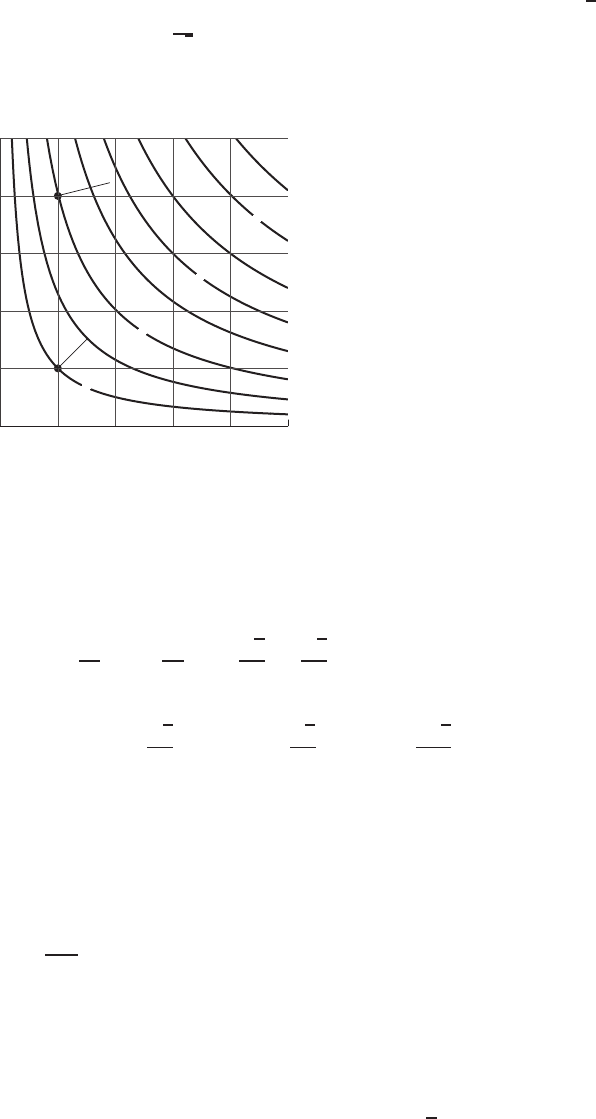
1372 Chapter Fourteen /SOLUTIONS
81. The directional derivative is approximately the change in z(as we move in direction ~v ) divided by the horizontal change
in position. In the direction of ~v we go from point (4,1) to point (2,2), and the value of zremains unchanged. We have
the directional derivative ≈0.
82. The gradient vectors are perpendicular to the level curves. To determine the length of the gradient vector, we estimate the
rate of change of the function from the contour diagram. At (1,1), the value of fchanges from 1 to 2 in a distance of √2
(as it moves from (1,1) to (2,2)), so the length of grad fis 1
√2≈0.7. At (1,4), the value of fchanges slightly faster
(the lines are closer together), so grad fis slightly longer here. In fact, the value of fchanges from 2to 3as we move
from (1,4) to (2.2,4.2) a distance of about 1.2. So the new length is 1/1.2 = 0.8.
12345
0
1
2
3
4
5
x
y
4
3
2
1
✒
✿
Figure 14.52
: Gradient Vectors
83. (a) The gradient vector at the point x= 1,y= 2 is
∇z=∇(x2y) = 2xy~
i+x2~
j= 4
~
i+~
j .
The unit vector making an angle of 5π/4with the x-axis is
~u = cos 5π
4~
i+ sin 5π
4~
j=−√2
2~
i−√2
2~
j .
The directional derivative in this direction is
f~u (1,2) = ∇z·~u = (4
~
i+~
j)·√2
2(−~
i−~
j) = −√2
2(4 + 1) = −5√2
2.
(b) The directional derivative is a maximum in the direction of the gradient vector ∇z= 4
~
i+~
j.
84. (a) Incorrect. kgrad Hkis not the rate of change of H. In fact, there’s no such thing as the rate of change of H, although
directional derivatives can give its rate of change in a particular direction. For example, this expression would give
the wrong answer if the ant was crawling along a contour of H, since then the rate of change of the temperature it
experiences is zero even though kgrad Hkand ~v might not be zero.
(b) Correct. If ~u =~v /k~v k, then
grad H·~v = grad H·~v
k~v kk~v k= (grad H·~u )k~v k=H~u k~v k
=(Rate of change of Hin direction ~u in deg/cm)(Speed of ant in cm/sec)
=Rate of change of Hin deg/sec.
(c) Incorrect, this is the directional derivative, which gives the rate of change with respect to distance, not time.
85. (a) We choose a coordinate system with the origin at the buoy, the x-axis pointing east and the y-axis pointing north.
Then the boat is at the point with position vector ~
i−2~
j. So a vector pointing in the direction of the buoy from the
boat’s position is ~
0−(
~
i−2~
j) = −~
i+ 2~
j, and a unit vector in this direction is ~u = (1/√5)(−~
i+ 2~
j). We have
grad h=−30 ·2x
~
i−20 ·2y~
j=−60x
~
i−40y~
j ,

SOLUTIONS to Review Problems for Chapter Fourteen 1373
so at the boat’s position, x= 1 and y=−2, we have
grad h=−60 ·1
~
i−40(−2)~
j=−60
~
i+ 80~
j .
So the directional derivative of the depth in the direction of the buoy is
grad h·~u = (−60
~
i+ 80~
j)·1
√5(−~
i+ 2~
j) = 60 + 160
√5= 98.387 ft/mile.
So the depth is increasing at a rate of 98.387 ft/mile.
(b) The boat is moving at 3 mph and from part (a) we know that the depth is changing at 98.387 ft/mi. So
Rate of change of depth with respect to time =(Speed)(Rate of change of depth with respect to distance)
= 3 miles
hour 98.387 ft
mile = 295.161 ft/hour.
86. (a) The vector grad f= 2
~
i−5~
jis perpendicular to the level curve at the point (1,3). Now the vector 5
~
i+ 2~
jis
perpendicular to the vector 2
~
i−5~
j. Thus, the vector 5
~
i+2~
jis tangent to curve. (There are many other vectors with
this property, such as −5
~
i−2~
j , 10
~
i+ 4~
j , etc.) The slope of the tangent line is therefore 2/5.Since the tangent
line goes through the point (1,3), its equation is
y−3 = 2
5(x−1)
or
y=2
5x+13
5.
(b) The surface z=f(x, y)can be written in the form
F(x, y, z) = f(x, y)−z= 0.
The normal the this surface is
grad F=fx
~
i+fy~
j−~
k .
Thus, at the point (1,3,7), the normal is
grad F(1,3,7) = 2
~
i−5~
j−~
k .
Thus, the equation of the tangent plane is
2x−5y−z= 2(1) −5(3) −7 = −20
2x−5y−z+ 20 = 0.
87. (a) We want the partial derivative with respect to xat the point (2,1,5), so
∂H
∂x (2,1,5)
=−2xe−(x2+2y2+3z2)(2,1,5)
=−4e−81 ◦C/meter.
(b) By the chain rule,
∂H
∂t =∂H
∂x ·∂x
∂t =−4e−81 ·10 = −40e−81 ◦C/sec.
(c) The magnitude of the gradient gives the maximum rate of change, so
grad H(2,1,5)
=−e−(x2+2y2+3z2)(2x
~
i+ 4y~
j+ 6z~
k)(2,1,5)
=−e−81(4
~
i+ 4~
j+ 30~
k).
Thus
||grad H|| =e−81p42+ 42+ 302=√932e−81 ◦C/meter.
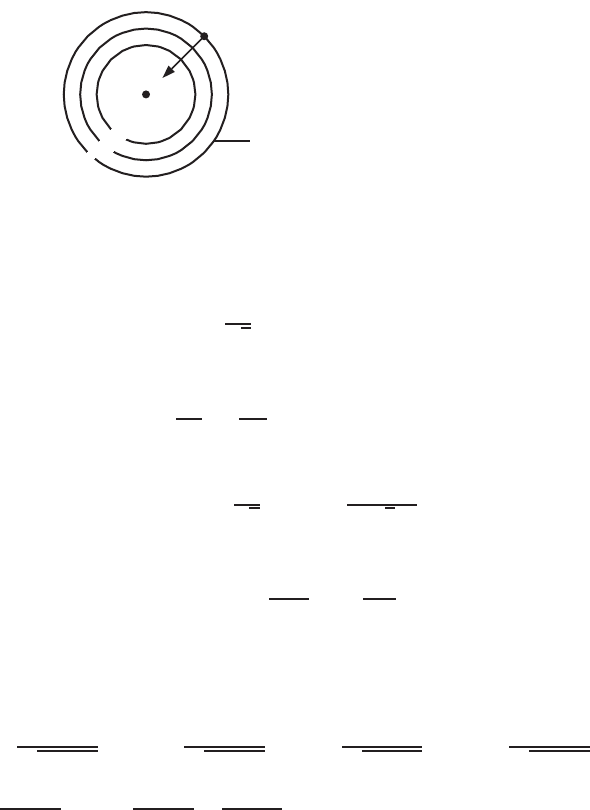
1374 Chapter Fourteen /SOLUTIONS
88. The point (4,1,3) lies on the surface. The surface is the level surface of the function
F(x, y, z) = f(x, y)−z= 0.
The normal to the surface at the point (4,1,3) is
grad F(4,1,3) = fx(4,1)
~
i+fy(4,1)~
j−~
k= 2
~
i−~
j−~
k .
Thus the equation of the tangent plane is
2x−y−z= 2(4) −1−3 = 4
2x−y−z= 4
89. The temperature increases fastest in the direction of the gradient vector, namely grad T=−2x
~
i−2y~
j . Figure 14.53
shows that the gradient vector points radially inward.
T= 100
grad T=−2x
~
i−2y~
j
✛
Level curves of
T
are circles
0
36
64
Figure 14.53
90. (a) If ~
jpoints north and~
ipoints east, then the direction the car is driving is ~
j−~
i. A unit vector in this direction is
~u =1
√2(~
j−~
i).
The gradient of the height function is
grad h=∂h
∂E~
i+∂h
∂N ~
j= 50
~
i+ 100~
j .
So the directional derivative is
h~u = grad g·~
h= (50
~
i+ 100~
j)·1
√2(~
j−~
i) = 100 −50
√2= 35.355 ft/mi.
(b) The car is traveling at vmi/hr, so
Rate of change of with respect to time =vmiles
hour 35.355 ft
mile = 35.355vft/hour.
91. At points (x, y)where the gradients are defined and are not the zero vector, the level curves of fand gintersect at right
angles if and only grad f·grad g= 0.
We have
grad f·grad g= x
px2+y2+ 1!~
i+y
px2+y2
~
j!· x
px2+y2−1!~
i+y
px2+y2
~
j!
=x2
x2+y2−1+y2
x2+y2=x2+y2
x2+y2−1 = 0.
The level curves of fand gare parabolas that cross at right angles except at the point (0,0). See Figure 14.54.

SOLUTIONS to Review Problems for Chapter Fourteen 1375
x
y
g=c2
f=c1
Figure 14.54
92. Since V=m/r, where ris the distance from (x, y, z)to (x0, y0, z0), we have r=p(x−x0)2+ (y−y0)2+ (z−z0)2,
so
V=m
p(x−x0)2+ (y−y0)2+ (z−z0)2,
∂V
∂x =−m(x−x0)
(x−x0)2+ (y−y0)2+ (z−z0)23/2,
∂2V
∂x2=3m(x−x0)2
(x−x0)2+(y−y0)2+ (z−z0)25/2−m
(x−x0)2+(y−y0)2+ (z−z0)23/2
Similarly,
∂2V
∂y2=3m(y−y0)2
(x−x0)2+ (y−y0)2+ (z−z0)25/2−m
(x−x0)2+ (y−y0)2+ (z−z0)23/2
and,
∂2V
∂z2=3m(z−z0)2
(x−x0)2+ (y−y0)2+ (z−z0)25/2−m
(x−x0)2+ (y−y0)2+ (z−z0)23/2,
So
∂2V
∂x2+∂2V
∂y2+∂2V
∂z2=3m(x−x0)2+ (y−y0)2+ (z−z0)2
(x−x0)2+ (y−y0)2+ (z−z0)25/2−3m
(x−x0)2+ (y−y0)2+ (z−z0)23/2
= 0
93. Write V=f(u)where u=x+ct, then using the chain rule
∂V
∂x =df
du ·∂u
∂x =f′(u)(1).
Similarly,
∂V
∂t =df
du ·∂u
∂t =f′(u)(c) = cf′(u).
Thus ∂V
∂t =cf′(u) = c∂V
∂x .
94. (a) The chain rule gives
∂z
∂x =∂z
∂u
∂u
∂x +∂z
∂v
∂v
∂x = (2u−ev)1 + (−uev)2.
At (x, y) = (1,2), we have u= 1 + 2 ·2 = 5 and v= 2 ·1−2 = 0, so
∂z
∂y (x,y)=(1,2)
= (2 ·5−e0)1 −5e0·2 = −1.
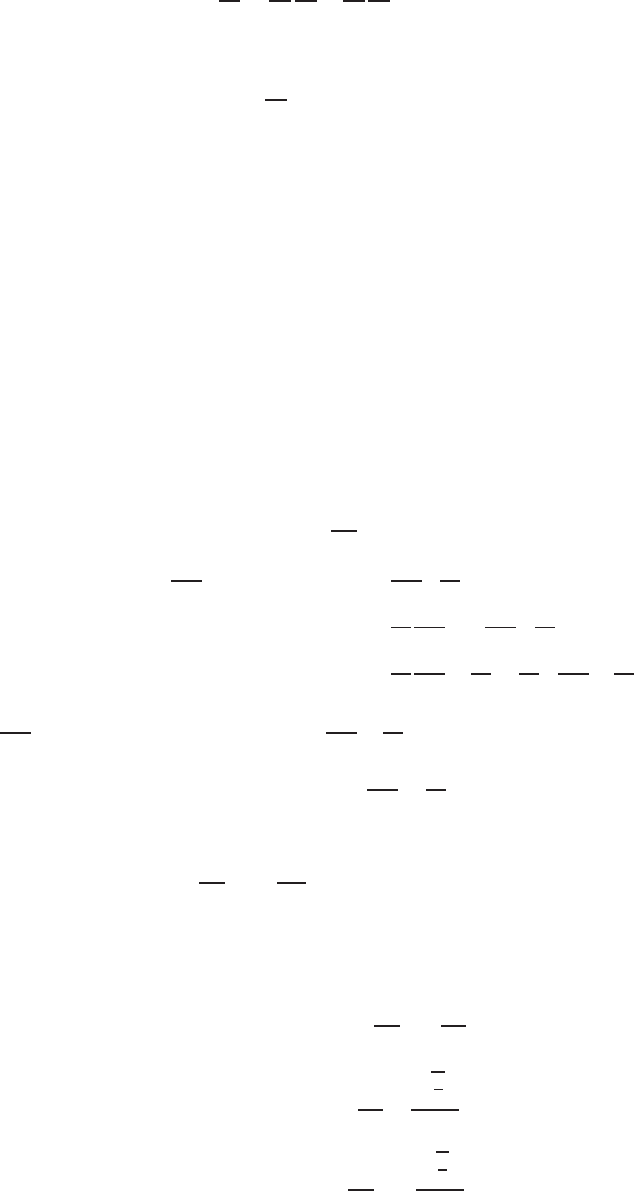
1376 Chapter Fourteen /SOLUTIONS
(b) The chain rule gives
∂z
∂y =∂z
∂u
∂u
∂y +∂z
∂v
∂v
∂y = (2u−ev)2 + (−uev)(−1).
At (x, y) = (1,2), we have (u, v) = (5,0), so
∂z
∂y (x,y)=(1,2)
= (2 ·5−e0)2 + 5e0= 23.
95. All are done using the chain rule.
(a) We have u=x,v=y,w= 3. Thus ∂u/∂x = 1,∂v/∂x = 0,∂w/∂x = 0, so
Gx(x, y) = Fu(x, y, 3)(1) + Fv(x, y, 3)(0) + Fw(x, y, 3)(0) = Fu(x, y, 3).
(b) We have u= 3,v=y,w=x. Thus ∂u/∂x = 0,∂v/∂x = 0,∂w/∂x = 1, so
Gx(x, y) = Fu(3, y, x)(0) + Fv(3, y, x)(0) + Fw(3, y, x)(1) = Fw(3, y, x).
(c) We have u=x,v=y,w=x. Thus ∂u/∂x = 1,∂v/∂x = 0,∂w/∂x = 1, so
Gx(x, y) = Fu(x, y, x)(1) + Fv(x, y, x)(0) + Fw(x, y, x)(1) = Fu(x, y, x) + Fw(x, y, x).
(d) We have u=x,v=y,w=xy. Thus ∂u/∂x = 1,∂v/∂x = 0,∂w/∂x =y, so
Gx(x, y) = Fu(x, y, xy)(1) + Fv(x, y, xy)(0) + Fw(x, y, xy)(y)
=Fu(x, y, xy) + yFw(x, y, xy).
96. Average productivity increases as x1increases if ∂
∂x1(average productivity)>0. Now
∂
∂x1
(average productivity) =∂
∂x1P
x1
=1
x1
∂P
∂x1
+P∂
∂x11
x1
=1
x1
∂P
∂x1−P
x2
1
=1
x1∂P
∂x1−P
x1
So ∂
∂x1
(average productivity) >0means that ∂P
∂x1−P
x1>0, i.e.,
∂P
∂x1
>P
x1
.
97. The differential is
dP =∂P
∂L dL +∂P
∂K dK = 10L−0.75K0.75 dL + 30L0.25K−0.25dK.
When L= 2 and K= 16, this is
dP ≈47.6dL + 17.8dK.
98. The error, dT , in the period Tis given by
dT =∂T
∂l dl +∂T
∂g dg,
where
∂T
∂l =ql
gπ
l
and
∂T
∂g =−ql
gπ
g,
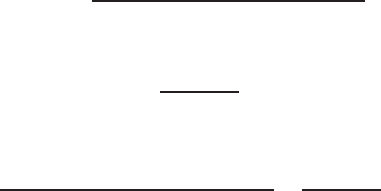
SOLUTIONS to Review Problems for Chapter Fourteen 1377
so that
Tl(2,9.8) = 0.7096, Tg(2,9.8) = −0.1448.
We also have that
dl =−0.01, dg = 0.01.
The maximum discrepancy in the period is then given by
dT = 0.7096(−0.01) −0.1448(0.01) = −0.008544.
99. Looking at the contour diagram, we see that the contours are almost straight lines that are reasonably evenly spaced, so
treating the function as linear is not a bad approximation. The monthly payment mis a function of two variables, P, the
dollars you borrow, and r, the interest rate. We are going to use the formula
m(P, r)≈m(P0, r0) + mp(P0, r0)(P−P0) + mr(P0, r0)(r−r0)
to approximate the payment m(P, r). The amount of $6000 and the interest rate 11% would probably be reasonable
choices for our P0and r0.
Directly from the Figure 12.8 on page 691, we have
m(6000,0.11) = $130
Next we approximate mp(6000,0.11) by a difference quotient.
mp(6000,0.11) ≈m(6000 + h, 0.11) −m(6000,0.11)
h
Here we choose h= 500, and we get m(6500,0.11) = 140 from the figure, so
mp(6000,0.11) ≈140 −130
500 = 0.02
Next we approximate mr(6000,0.11) by taking h= 0.03 and m(6000,0.11 + 0.03) = m(6000,0.14) = 140 from the
figure,
mr(6000,0.11) ≈m(6000,0.11 + h)−m(6000,0.11)
h=140 −130
0.03 ≈333.33
Thus we have:
m(P, r)≈130 + 0.02(P−6000) + 333.33(r−0.11)
=−26.67 + 0.02P+ 333.33rin dollars
The constants in the answer tell us several useful things. The slope of 0.02 along the Paxis tells us how much our monthly
payment will increase if we decide to borrow more money; we can expect to pay about 2 cents on each extra dollar every
month. The slope in the rdirection tells us how much our payment will change if the interest rate changes. We can expect
to pay an extra $333.33 each month for each point the interest rate goes up. The constant cis a gauge of the non-linearity
of this function. We know that if we borrow no money at zero percent interest, we should expect to not have a monthly
payment (m= 0). The constant we calculated is negative which implies that the bank will pay us $26.67 each month if
we do not borrow any money! So, we should bear in mind that the function we have calculated is only useful close to the
point at which we made the approximation, in this case P0= 6000 and r0= 11%.
100. (a) The local linearization of fnear (2,1) is 7−3(x−2) + 4(y−1), so the equation of the tangent plane is:
z= 7 −3(x−2) + 4(y−1).
(b) We use local linearity. The contour is f(x, y) = 7, so to find the tangent line to the contour, we set the local
linearization for fequal to 7:
7−3(x−2) + 4(y−1) = 7
Thus, an equation for the tangent line is
−3(x−2) + 4(y−1) = 0.
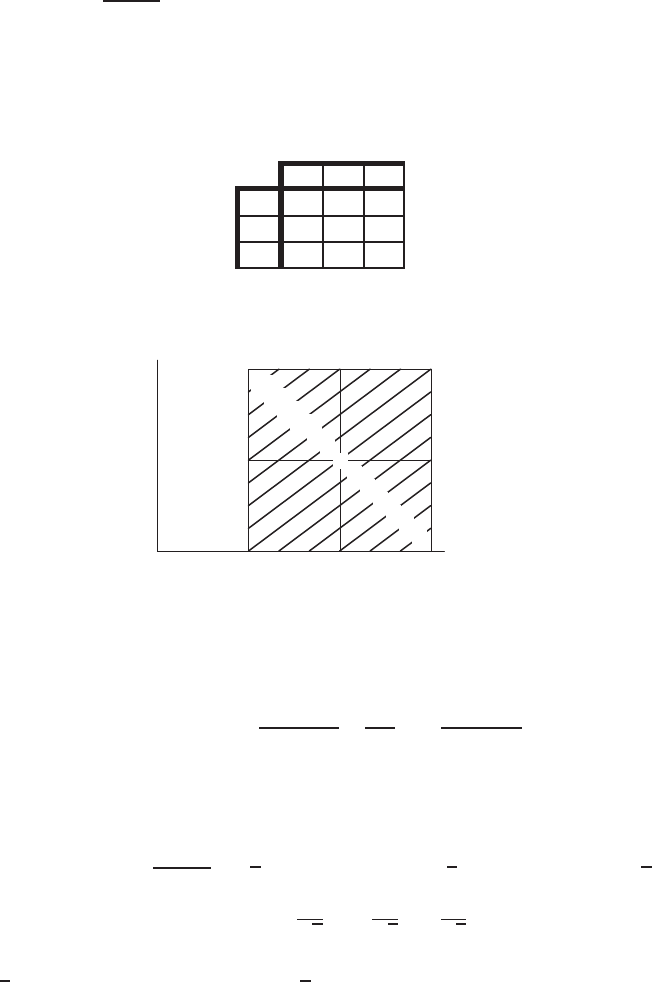
1378 Chapter Fourteen /SOLUTIONS
101. (a) Rewrite the equation of the tangent plane:
−3(x−2) + 4(y−1) −(z−7) = 0.
Then we see a normal vector to the plane is −3
~
i+ 4~
j−~
k.
(b) Since the gradient is perpendicular to contours, a normal vector to the tangent line is −3
~
i+ 4~
j. Or, setting the local
linearization for fequal to 7, we get that the equation for the tangent line is −3(x−2) + 4(y−1) = 0.Thus a
normal vector to the tangent line is −3
~
i+ 4~
j.
102. The directional derivative, or slope, of fat (2,1) in the direction perpendicular to these contours is the length of the
gradient. At the point (2,1), we have grad f=−3
~
i+ 4~
j, so kgrad fk= 5. Thus if dis the distance between the
contours, we have 7.3−7
d=Slope in direction perpendicular to contours = 5.
Thus d= 0.3/5 = 0.06.
103. Using local linearity with the slope in the xdirection of −3and slope in the ydirection of 4, we get the values in
Table 14.9.
Table 14.9
x
y
0.9 1.0 1.1
1.8 7.2 7.6 8.0
2.0 6.6 7.0 7.4
2.2 6.0 6.4 6.8
104. See Figure 14.55.
1 3
1
213
12
11
10
9
8
7
6
5
4
3
2
1x
y
Figure 14.55
105. The bug is heading in the direction of −grad f. In that direction, the rate of cooling in degrees per centimeter is given by
the magnitude of the gradient, which is 5. Since the bug is moving 3 centimeters per minute, in degrees per minute, we
have:
Rate of cooling = 5 degrees ◦C
cm ·3cm
min = 15 degrees ◦C
min .
106. By the chain rule,
fr(2,1) = fx(2,1) cos θ+fy(2,1) sin θ
fθ(2,1) = fx(2,1)(−rsin θ) + fy(2,1)(rcos θ).
Since x2+y2=r2, we have r=√22+ 12=√5, and cos θ=x/r = 2/√5, and sin θ=y/r = 1/√5. Thus
fr(2,1) = (−3) 2
√5+ (4) 1
√5=−2
√5
fθ(2,1) = (−3)(−1) + (4)(2) = 11.
For ~u = (1/√5)(2
~
i+~
j), we have f~u (2,1) = −2/√5. Since ~u is pointing radially out from the origin to the point
(2,1), we expect that f~u (2,1) = fr(2,1).
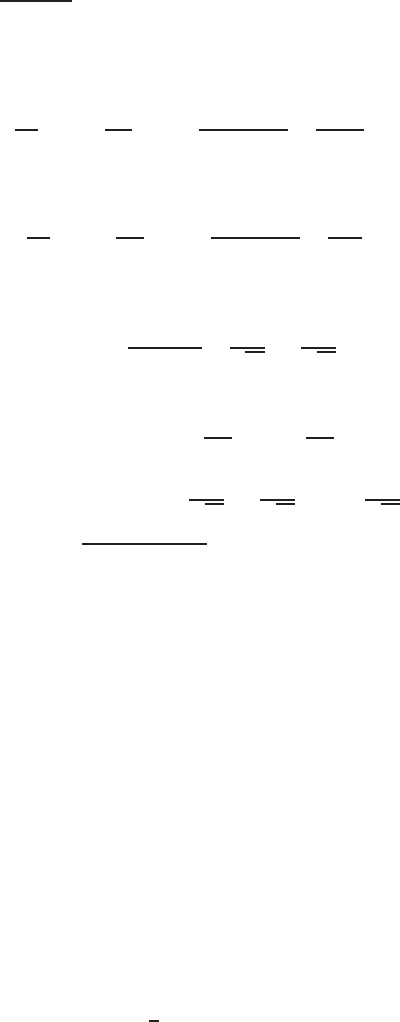
SOLUTIONS to Review Problems for Chapter Fourteen 1379
107. To increase fas much as possible, we should head in the direction of the gradient from the point (2,1). The rate of
increase of fin the direction of the gradient is the magnitude of the gradient. Since at the point (2,1), we know grad f=
−3
~
i+ 4~
j, the magnitude is 5. The furthest we can go from (2,1), inside the circle, is 0.1units, so the most we can
increase fis (0.1)(5) = 0.5. Thus
Largest value of function ≈f(2,1) + 0.5 = 7.5.
This value is achieved at the point obtained from (2,1) by a displacement of 0.1units in the direction of grad f, that is,
a displacement by the vector
(0.1) grad f
kgrad fk= (0.1)((−3/5)
~
i+ (4/5)~
j) = −0.06
~
i+ 0.08~
j .
Thus, the largest value of fis achieved at the point (2 −0.06,1 + 0.08) = (1.94,1.08).
108. (a) Fix y= 3. When xchanges from 2.00 to 2.01,f(x, 3) decreases from 7.56 to 7.42. So
∂f
∂x (2,3) ≈∆f
∆x(2,3)
=7.42 −7.56
2.01 −2.00 =−0.14
0.01 =−14.
Fix x= 2, when ychanges from 3.00 to 3.02,f(2, y)increases from 7.56 to 7.61. So
∂f
∂y (2,3) ≈∆f
∆y(2,3)
=7.61 −7.56
3.02 −3.00 =0.05
0.02 = 2.5.
(b) Since the unit vector ~u of the direction~
i+ 3~
jis
~u =~
i+ 3~
j
k~
i+ 3~
jk=1
√10
~
i+3
√10
~
j ,
f~u (2,3) = grad f(2,3) ·~u ≈ ∆f
∆x(2,3)
~
i+∆f
∆y(2,3)
~
j!·~u
= (−14
~
i+ 2.5~
j)·1
√10
~
i+3
√10
~
j=−6.5
√10 ≈ −2.055.
(c) Maximum rate equals kgrad fk ≈ p(−14)2+ (2.5)2≈14.221 in the direction of the gradient which is approxi-
mately equal to −14
~
i+ 2.5~
j.
(d) The equation of the level curve is
f(x, y) = f(2,3) = 7.56.
(e) The vector must be perpendicular to grad f, so ~v = 2.5
~
i+ 14~
jis a possible answer. (There are many others.).
(f) The differential at the point (2,3) is
df =−14 dx + 2.5dy.
If dx = 0.03,dy = 0.04, we get
df =−14(0.03) + 2.5(0.04) = −0.32.
The df approximates the change in fwhen (x, y)changes from (2,3) to (2.03,3.04).
109. Let us first collect the computations that we will need.
f(x, y) = cos (x+ 2y) sin (x−y),
fx(x, y) = cos (x+ 2y) cos (x−y)−sin (x−y) sin (x+ 2y)
= cos (x+ 2y+x−y) = cos (2x+y),
fy(x, y) = −cos (x+ 2y) cos (x−y)−2 sin (x−y) sin (x+ 2y)
=−cos (x+ 2y−(x−y)) −sin (x+ 2y) sin (x−y)
=−cos (3y) + 1
2[cos (2x+y)−cos (3y)]

1380 Chapter Fourteen /SOLUTIONS
=1
2cos (2x+y)−3
2cos (3y),
fxx(x, y) = −2 sin (2x+y),
fxy (x, y) = −sin (2x+y),
fyy(x, y) = −1
2sin (2x+y) + 9
2sin (3y).
Then
f(0,0) = 0,
fx(0,0) = 1,
fy(0,0) = −1,
fxx(0,0) = 0,
fxy(0,0) = 0,
fyy(0,0) = 0.
Hence the quadratic Taylor polynomial P(x, y)of f(x, y)at (0,0) is
P(x, y) = f(0,0) + fx(0,0)x+fy(0,0)y
+1
2fxx(0,0)x2+fxy (0,0)xy +1
2fyy(0,0)y2
=x−y.
110. (a) The first-order Taylor polynomial of a function fabout a point (a, b)is equal to
f(a, b) + fx(a, b)(x−a) + fy(a, b)(y−b).
Computing the partial derivatives, we get:
fx= 2(x−1)e(x−1)2+(y−3)2
fy= 2(y−3)e(x−1)2+(y−3)2
fx(0,0) = 2(−1)e(−1)2+(−3)2
=−2e10
fy(0,0) = 2(−3)e(−1)2+(−3)2
=−6e10
Thus,
f(x, y)≈e10 −2e10x−6e10y
(b) The second-order Taylor polynomial of a function fabout the point (1,3) is given by
f(1,3) + fx(1,3)(x−1) + fy(1,3)(y−3)
+1
2fxx(1,3)(x−1)2+fxy (1,3)(x−1)(y−3) + 1
2fyy(1,3)(y−3)2.
Computing the partial derivatives, we get:
fx= 2(x−1)e(x−1)2+(y−3)2
fy= 2(y−3)e(x−1)2+(y−3)2
fxx = (4(x−1)2+ 2)e(x−1)2+(y−3)2
fxy = 4(x−1)(y−3)e(x−1)2+(y−3)2
fyy= (4(y−3)2+ 2)e(x−1)2+(y−3)2
Substituting in the point (1,3) to these partial derivatives, we get:
fx(1,3) = 0

SOLUTIONS to Review Problems for Chapter Fourteen 1381
fy(1,3) = 0
fxy (1,3) = 0
fxx(1,3) = (4(0)2+ 2)e02+02= 2
fyy(1,3) = (4(0)2+ 2)e02+02= 2
Thus,
f(x, y)≈e0+ 0(x−1) + 0(y−3) + 2
2(x−2)2+ 0(x−1)(y−3) + 2
2(y−3)2
f(x, y)≈1 + (x−1)2+ (y−3)2.
(c) A vector perpendicular to the level curve is grad f. At the point (0,0), we have
grad f=fx(0,0)
~
i+fy(0,0)~
j
Computing partial derivatives, we have
fx= 2(x−1)e(x−1)2+(y−3)2
fy= 2(y−3)e(x−1)2+(y−3)2
fx(0,0) = 2(−1)e(−1)2+(−3)2
=−2e10
fy(0,0) = 2(−3)e(−1)2+(−3)2
=−6e10
Therefore, a perpendicular vector is grad f=−2e10
~
i−6e10~
j. Any multiple of grad f, say −2
~
i−6~
j, will
do.
(d) Since the surface can be represented by the level surface
F(x, y, z) = f(x, y)−z= 0,
a vector perpendicular to the surface at (0,0) is given by
grad F=fx(0,0)
~
i+fy(0,0)~
j−~
k=−2e10
~
i−6e10~
j−~
k
111. (a) ft(π
2,π
2)is negative since we move from zero contour of fto negative contours as tslightly increases and x=π
2.
ft(π
2, π)is positive since fincreases with time tfrom t=πand x=π
2.
When ft(π
2, b)is positive, the point on the string at x=π
2is moving upward at t=b. It moves downward for
ft(π
2, b)negative at t=b.
(b) ft(π
2, t)is positive for π < t < 2π. For these t,fmoves to larger and larger contours at x=π
2.
(c) For any fixed values of tbetween 0 and π
2,fincreases with xfor xbetween 0 and 3π
2. Also for any fixed tbetween
3π
2and 5π
2,fincreases with xfor xbetween 0 and 3π
2. Hence, fx(x, t)is positive for 0< x < 3π/2and teither
satisfying 0< t < π/2or 3π/2<t<5π/2.
CAS Challenge Problems
112. (a) Using a CAS to calculate the partial derivatives, we find
f(0,0) = 1
6fx(0,0) = 1
9fy(0,0) = 1
fxx(0,0) = −1
54 fxy(0,0) = 2
3fyy(0,0) = 3
Thus the quadratic approximation is
Q(x, y) = 1
6+x
9+y−x2
108 +2xy
3+3y2
2.
(b) The CAS gives
ex
5 + e2x=1
6+x
9−x2
108 +···
(1 + sin 3y)2= 1 + 6y+ 9y2+···

1382 Chapter Fourteen /SOLUTIONS
Multiplying the two together, we get
1
6+x
9−x2
108 +···(1 + 6y+ 9y2+···) = 1
6+x
9+y−x2
108 +2xy
3+3y2
2+···
which is the quadratic approximation we obtained in part (a).
(c) We have
g(x) = g(0) + g′(0)x+g′′(0)
2x2+···
h(y) = h(0) + h′(0)y+h′′(0)
2y2+···
Multiplying these together, we get
g(0)h(0) + g′(0)h(0)x+g(0)h′(0)y+g′′(0)
2h(0)x2+g′(0)h′(0)xy +g(0) h′′(0)
2y2+···
On the other hand,
f(0,0) = g(0)h(0), fx(0,0) = g′(0)h(0), fy(0,0) = g(0)h′(0),
fxx(0,0) = g′′(0)h(0), fxy(0,0) = g′(0)h′(0), fyy (0,0) = g(0)h′′(0)
Thus the quadratic approximation to fis the same as the product of the approximations to gand h.
113. (a) We have f(1,2) = A0+A1+2A2+A3+2A4+4A5,fx(1,2) = A1+2A3+2A4, and fy(1,2) = A2+A4+4A5,
so the linear approximation is
L(x, y) = A0+A1+ 2A2+A3+ 2A4+ 4A5+ (A1+ 2A3+ 2A4)(x−1) + (A2+A4+ 4A5)(y−2).
Also, m(t) = 1 + B1tand n(t) = 2 + C1t.
(b) Using a CAS to compute the derivatives, we find that they are both the same:
d
dt f(x(t), y(t))|t=0 =d
dt l(m(t), n(t))|t=0 =A1B1+ 2A3B1+ 2A4B1+A2C1+A4C1+ 4A5C1.
This can be explained using the chain rule and the fact that the derivative of a function at a point is the same as the
derivative of its linear approximation there:
d
dt f(x(t), y(t))|t=0 =∂
∂x f(x(0), y(0))x′(0) + ∂
∂y f(x(0), y(0))y′(0)
=∂
∂x l(x(0), y(0))m′(0) + ∂
∂y l(x(0), y(0))n′(0) = d
dt l(m(t), n(t))|t=0
114. (a) We have
f(1,2) = A0+A1+ 2A2+A3+ 2A4+ 4A5,
fx(1,2) = A1+ 2A3+ 2A4,
fy(1,2) = A2+A4+ 4A5,
fxx(1,2) = 2A3,
fxy (1,2) = A4,
fyy(1,2) = 2A5.
Thus Q(x, y) = (A0+A1+ 2A2+A3+ 2A4+ 4A5) + (A1+ 2A3+ 2A4)(x−1) + (A2+A4+ 4A5)(y−
2) + A3(x−1)2+A4(x−1)(y−2) + A5(y−2)2. Expanding this expression in powers of xand y, we find
Q(x, y) = A0+A1x+A2y+A3x2+A4xy +A5y2=f(x, y)
.
(b) The quadratic expansion for fabout (1,2) is equal to fitself. This is because fis already a quadratic function, and
is true about any point (a, b).
(c) The linear approximation of f(x, y)at (1,2) is:
A0+A1+ 2A2+A3+ 2A4+ 4A5+ (A1+ 2A3+ 2A4)(x−1) + (A2+A4+ 4A5)(y−2).
When we expand this we get
A0−A3+A4−4A5+ (A1+ 2A3+ 2A4)x+ (A2+A4+ 4A5)y.
This is not the same as f(x, y), and it is not even the same as the linear part of f(x, y), namely A0+A1x+A2y.
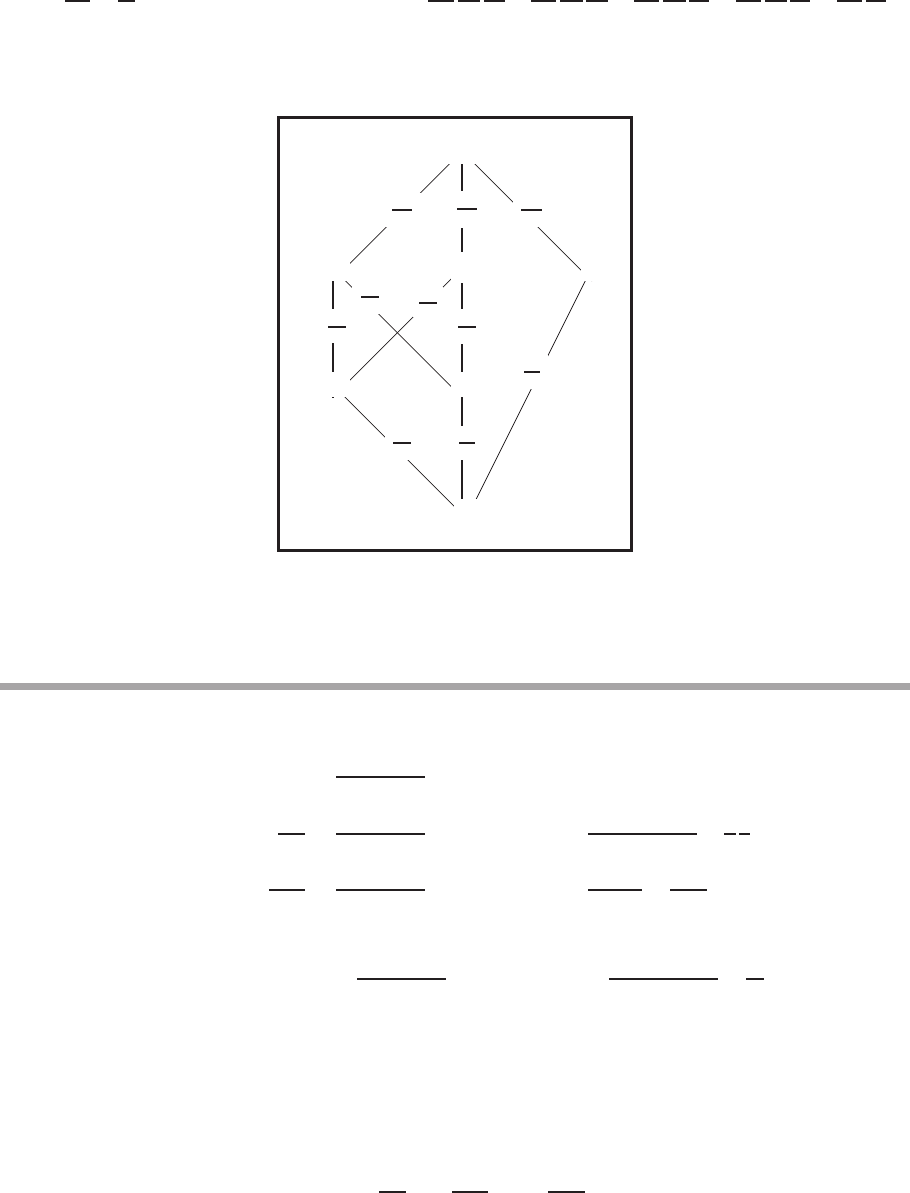
PROJECTS FOR CHAPTER FOURTEEN 1383
115. The computer algebra system gives:
dw
dt =d
dt f(x(u(t), v(t)), y(u(t), v(t)), z(t)) = ∂w
∂x
∂x
∂u
du
dt +∂w
∂y
∂y
∂u
du
dt +∂w
∂x
∂x
∂v
dv
dt +∂w
∂y
∂y
∂v
dv
dt +∂w
∂z
dz
dt
This agrees with the result obtained using the chain rule and the tree diagram in Figure 14.56. The diagram shows four
paths from wto t, each corresponding to one of the terms in the expression for dw/dt.
w
xyz
u v
t
∂w
∂x
∂w
∂y ∂w
∂z
∂x
∂v
∂x
∂u
∂y
∂u ∂y
∂v
du
dt
dv
dt
dz
dt
Figure 14.56
PROJECTS FOR CHAPTER FOURTEEN
1. (a) Calculating the necessary partial derivatives:
T(x, y, z, t) = 1
(4πKt)3/2e−(x2+y2+z2)/4Kt
∂T
∂t =1
(4πKt)3/2e−(x2+y2+z2)/4Kt x2+y2+z2
4Kt2−3
2
1
t
∂2T
∂x2=1
(4πKt)3/2e−(x2+y2+z2)/4Kt x2
4K2t2−1
2Kt
Thus,
K(Txx +Tyy +Tzz) = 1
(4πKt)3/2e−(x2+y2+z2)/4Kt x2+y2+z2
4Kt2−3
2t=Tt
(b) For t=constant, the level surfaces are given by
x2+y2+z2=c2, c =constant
which is an equation of a sphere centered at origin.
(c) With t=constant,grad T=Tx
~
i+Ty~
j+Tz~
k.Since
∂T
∂x =−2x
4KtT=−x
2KtT
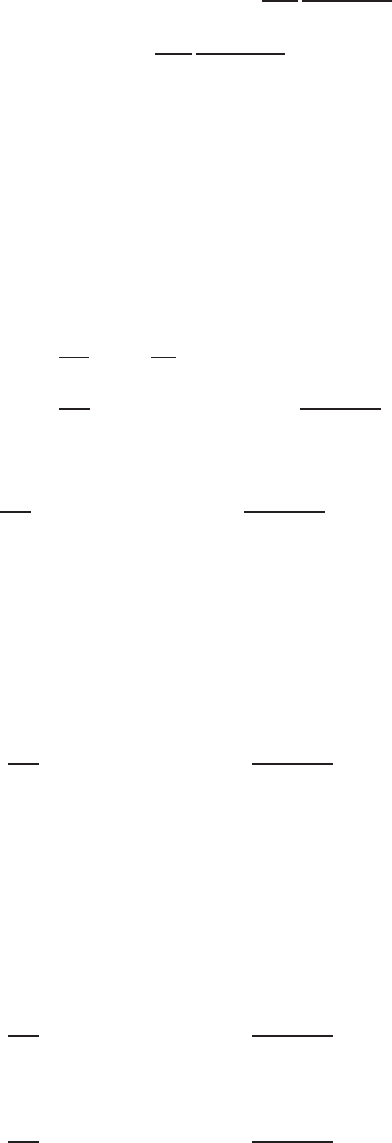
1384 Chapter Fourteen /SOLUTIONS
and similarly for Tyand Tz. Thus we have
grad T(x, y, z) = −(x
~
i+y~
j+z~
k)1
2Kt
1
(4πKt)3/2e−(x2+y2+z2)/4Kt
= (−~
r)1
2Kt
1
(4πKt)3/2e−r2/4Kt,where ~r =x
~
i+y~
j+z~
k
The heat flows toward lower temperatures, that is in the direction of −grad T. Since grad Tis in the
direction of −~r , heat is flowing outward and with exponentially decreasing magnitude.
2. (a) First, note that m,n, and (1 −q)are all positive.
Suppose we increase m, the number of students. Then there are more birthdays to match in a fixed
size year, and so qincreases. Thus we expect ∂q/∂m to be positive, which is the case. On the other hand,
if we increase n, the number of days in a year, then there are more slots for birthdays in a year, and so less
chance of matching. This means qdecreases, and so we expect ∂q/∂n to be negative, which is the case.
(b) Since we do not have an exact formula for q, we find approximate values for qusing q(23,365) = 0.5073
and local linearization. The local linearization of qat (23,365) is
∆q≈∂q
∂m∆m+∂q
∂n∆n
=23
365(1 −0.5073)(m−23) −232
(2)(3652)(1 −0.5073)(n−365).
When m= 21 and n= 365 we have
∆q≈23
365(1 −0.5073)(21 −23) −232
(2)(3652)(1 −0.5073)(365 −365) = −0.0621.
Thus
q(21,365) = q(23,365) + ∆q
≈0.5073 −0.0621
= 0.4452.
(c) When m= 24 and n= 358,we have
∆q≈23
365(1 −0.5073)(24 −23) −232
(2)(3652)(1 −0.5073)(358 −365) = 0.0379.
Thus
q(24,358) = q(23,365) + ∆q
≈0.5073 + 0.0379
= 0.5452.
(d) We want to compare the values of qwhen m= 25 and n= 365 and when m= 23 and n= 365 −31 =
334. When m= 25 and n= 365 we have
∆q≈23
365(1 −0.5073)(25 −23) −232
(2)(3652)(1 −0.5073)(365 −365) = 0.0621.
On the other hand, when m= 23 and n= 334 we have
∆q≈23
365(1 −0.5073)(23 −23) −232
(2)(3652)(1 −0.5073)(334 −365) = 0.0312.
So adding 2 more students gives you a greater increase in probability than no birthdays in December.

PROJECTS FOR CHAPTER FOURTEEN 1385
(e) The number of possible choices of birthdays for all the students is nmsince each of the mstudents could
choose (have a birthday on) any of the ndays. We count the number of these choices for which there are no
matching birthdays as follows. The first student can choose any of ndays for his/her birthday. The second
student can choose any birthday that does not match the first student’s, that is, any of n−1days. The third
student can choose any birthday that does not match the first two students’, that is, any of n−2days; and
so on for all mstudents. So the number of choices of birthdays for all the students for which there is no
matching is n(n−1)(n−2) ···(n−(m−1)).Thus, the fraction of possible choices for which there is
no matching is
n(n−1)(n−2) ···(n−(m−1))
nm.
Then qis one minus the chance of no matching birthdays:
q(m, n) = 1 −n(n−1)(n−2) ···(n−(m−1))
nm.

15.1 SOLUTIONS 1387
CHAPTER FIFTEEN
Solutions for Section 15.1
Exercises
1. The contour diagrams in (I) and (V) show that the value of the function decreases as we move in any direction from the
critical point. Therefore, the function has a local maximum at P. The contour diagrams in (II) and in (VI) show that the
value of the function increases as we move in any direction from the critical point, and therefore Pis a local minimum.
The contour lines in (III) and (IV) are hyperbolas, and therefore, the critical point, P, is a saddle point.
2. The point Ais not a critical point and the contour lines look like parallel lines. The point Bis a critical point and is a local
maximum; the point Cis a saddle point.
3. (a) None.
(b) Points Eand G.
(c) Points Dand F.
4. At the origin g(0,0) = 0. Since y3≥0for y > 0and y3<0for y < 0, the function gtakes on both positive and negative
values near the origin, which must therefore be a saddle point. The second derivative test does not tell you anything since
D= 0.
5. At the origin f(0,0) = 0. Since x6≥0and y6≥0, the point (0,0) is a local (and global) minimum. The second
derivative test does not tell you anything since D= 0.
6. At the origin, the second derivative test gives
D=kxxkyy −(kxy )2=(−sin xsin y)(−sin xsin y)−(cos xcos y)2x=0,y=0
= sin20 sin20−cos20 cos20
=−1<0.
Thus k(0,0) is a saddle point.
7. At the origin h(0,0) = 1. Since cos xand cos yare never above 1, the origin must be a local (and global) maximum. The
second derivative test
D=hxxhyy −(hxy )2=(−cos xcos y)(−cos xcos y)−(sin xsin y)2x=0,y=0
=cos2xcos2y−sin2xsin2yx=0,y=0
= 1 >0
and hxx(0,0) <0, so (0,0) is a local maximum.
8. To find the critical points, we solve fx= 0 and fy= 0 for xand y. Solving
fx= 2x−2y= 0,
fy=−2x+ 6y−8 = 0.
We see from the first equation that x=y. Substituting this into the second equation shows that y= 2. The only critical
point is (2,2).
We have
D= (fxx)(fyy )−(fxy)2= (2)(6) −(−2)2= 8.
Since D > 0and fxx = 2 >0, the function fhas a local minimum at the point (2,2).
9. To find the critical points, we solve fx= 0 and fy= 0 for xand y. Solving
fx= 6 −2x+y= 0,
fy=x−2y= 0.

1388 Chapter Fifteen /SOLUTIONS
We see from the second equation that x= 2y. Substituting this into the first equation shows that y= 2. The only critical
point is (4,2).
We have
D= (fxx)(fyy )−(fxy)2= (−2)(−2) −12= 3.
Since D > 0and fxx =−2<0, the function fhas a local maximum at (4,2).
10. The partial derivatives give
fx= 2x+ 4 = 0 and fy=−2y+ 2 = 0.
Thus we have x=−2and y= 1, so (−2,1) is a critical point. We use the discriminant:
D= (fxx)(fyy )−(fxy)2= 2(−2) −0 = −4<0.
Since D < 0, we have a saddle point.
11. Setting fx= 0 and fy= 0 to find the critical point, we have
fx=−6x−4 + 2y= 0 and fy= 2x−10y+ 48 = 0,or
2y−6x= 4 and 10y−2x= 48.
Solving these equations simultaneously gives x= 1 and y= 5.
Since fxx =−6,fyy =−10 and fxy = 2 for all (x, y), at (1,5) the discriminant
D= (−6)(−10) −(2)2= 56 >0,and fxx <0.
Thus f(x, y)has a local maximum value at (1,5).
12. The partial derivatives give
fx=−2x+ 6 = 0 and fy= 4y−8 = 0.
Thus we have x= 3 and y= 2, so (3,2) is a critical point. We use the discriminant:
D= (fxx)(fyy )−(fxy)2= (−2)2 = −4<0.
Since D < 0, we have a saddle point.
13. At a critical point, fx= 0 and fy= 0.
fx= 2xy −2y= 2y(x−1) = 0,
fy=x2+ 4y−2x= 0.
In order for fxto be zero, we need y= 0 or x= 1. If y= 0, then fy=x2−2x=x(x−2) = 0 so x= 0 or x= 2.
Therefore (0,0) and (2,0) are both critical points. If x= 1, then fy= 4y−1 = 0 so y= 0.25. The three critical points
are (0,0),(2,0), and (1,0.25).
We use the discriminant to classify the three points. We have
D(x, y) = fxxfyy −f2
xy
= (2y)(4) −(2x−2)2
= 8y−(2x−2)2.
Checking each critical point, we see that
D(0,0) = −4<0, so (0,0) is a saddle point.
D(2,0) = −4<0, so (2,0) is also a saddle point.
D(1,0.25) = 2 >0and fxx(1,0.25) = 0.5>0, so (1,0.25) is a local minimum.
14. At a critical point
fx(x, y) = 6x2−6xy + 12x= 0
fy(x, y) = −3x2−12y= 0
From the second equation, we conclude that −3(x2+ 4y) = 0, so y=−1
4x2. Substituting for yin the first equation
gives
6x2−6x−1
4x2+ 12x= 0

15.1 SOLUTIONS 1389
or
x2+1
4x3+ 2x=x
4(4x+x2+ 8) = 0.
Thus x= 0 or x2+ 4x+ 8 = 0. The quadratic has no real solutions, so the only one critical point is (0,0).
At (0,0), we have
D(0,0) = fxxfyy −(fxy )2= (12)(−12) −02=−144 <0,
so (0,0) is a saddle point.
15. To find the critical points, we solve fx= 0 and fy= 0 for xand y. Solving
fx= 3x2−3 = 0
fy= 3y2−3 = 0
shows that x=±1and y=±1. There are four critical points: (1,1),(−1,1),(1,−1) and (−1,−1).
We have
D= (fxx)(fyy )−(fxy )2= (6x)(6y)−(0)2= 36xy.
At the points (1,−1) and (−1,1), we have D=−36 <0, so fhas saddle points at (1,−1) and (−1,1). At (1,1),
we have D= 36 >0and fxx = 6 >0, so fhas a local minimum at (1,1). At (−1,−1), we have D= 36 >0and
fxx =−6<0, so fhas a local maximum at (−1,−1).
16. To find the critical points, we solve fx= 0 and fy= 0 for xand y. Solving
fx= 3x2−6x= 0
fy= 3y2−3 = 0
shows that x= 0 or x= 2 and y=−1or y= 1. There are four critical points: (0,−1),(0,1),(2,−1), and (2,1).
We have
D= (fxx)(fyy )−(fxy )2= (6x−6)(6y)−(0)2= (6x−6)(6y).
At the point (0,−1), we have D > 0and fxx <0, so fhas a local maximum.
At the point (0,1), we have D < 0, so fhas a saddle point.
At the point (2,−1), we have D < 0, so fhas a saddle point.
At the point (2,1), we have D > 0and fxx >0, so fhas a local minimum.
17. To find the critical points, we solve fx= 0 and fy= 0 for xand y. Solving
fx= 3x2−3 = 0
fy= 3y2−12y= 0
shows that x=−1or x= 1 and y= 0 or y= 4. There are four critical points: (−1,0),(1,0),(−1,4), and (1,4).
We have
D= (fxx)(fyy)−(fxy)2= (6x)(6y−12) −(0)2= (6x)(6y−12).
At critical point (−1,0), we have D > 0and fxx <0, so fhas a local maximum at (−1,0).
At critical point (1,0), we have D < 0, so fhas a saddle point at (1,0).
At critical point (−1,4), we have D < 0, so fhas a saddle point at (−1,4).
At critical point (1,4), we have D > 0and fxx >0, so fhas a local minimum at (1,4).
18. Find the critical point(s) by setting
fx= (xy + 1) + (x+y)·y=y2+ 2xy + 1 = 0,
fy= (xy + 1) + (x+y)·x=x2+ 2xy + 1 = 0,
then we get x2=y2, and so x=yor x=−y.
If x=y, then x2+ 2x2+ 1 = 0, that is, 3x2=−1, and there is no real solution. If x=−y, then x2−2x2+ 1 = 0,
which gives x2= 1. Solving it we get x= 1 or x=−1, then y=−1or y= 1, respectively. Hence, (1,−1) and (−1,1)
are critical points.
Since
fxx(x, y) = 2y,
fxy (x, y) = 2y+ 2xand
fyy(x, y) = 2x,

1390 Chapter Fifteen /SOLUTIONS
the discriminant is
D(x, y) = fxxfyy −f2
xy
= 2y·2x−(2y+ 2x)2
=−4(x2+xy +y2).
thus
D(1,−1) = −4(12+ 1 ·(−1) + (−1)2) = −4<0,
D(−1,1) = −4((−1)2+ (−1) ·1 + 12) = −4<0.
Therefore (1,−1) and (−1,1) are saddle points.
19. At a critical point, fx= 0,fy= 0.
fx= 8y−(x+y)3= 0,we know 8y= (x+y)3.
fy= 8x−(x+y)3= 0,we know 8x= (x+y)3.
Therefore we must have x=y. Since (x+y)3= (2y)3= 8y3, this tells us that 8y−8y3= 0. Solving gives y= 0,±1.
Thus the critical points are (0,0),(1,1),(−1,−1).
fyy =fxx =−3(x+y)2, and fxy = 8 −3(x+y)2.
The discriminant is
D(x, y) = fxxfyy −f2
xy
= 9(x+y)4−64 −48(x+y)2+ 9(x+y)4
=−64 + 48(x+y)2.
D(0,0) = −64 <0, so (0,0) is a saddle point.
D(1,1) = −64 + 192 >0and fxx(1,1) = −12 <0, so (1,1) is a local maximum.
D(−1,−1) = −64 + 192 >0and fxx(−1,−1) = −12 <0, so (−1,−1) is a local maximum.
20. To find the critical points, we solve fx= 0 and fy= 0 for xand y. Solving
fx=e2x2+y2(4x)= 0,
fy=e2x2+y2(2y) = 0,
shows that the only critical point is (0,0).
We have
D= (fxx)(fyy )−(fxy )2=e2x2+y2(4 + (4x)2)·e2x2+y2(2 + (2y)2)−(e2x2+y2(4x·2y))2.
At (0,0), we have D= 4 ·2−02>0and fxx = 4 >0, so the function has a local minimum at the point (0,0).
Problems
21. At the critical point x= 1,y= 0,
fx= 2x+A= 0,so 2 + A= 0 or A=−2
fy= 2y= 0.
Thus, f(x, y) = x2−2x+y2+Bhas a critical point at (1,0). Since fxx = 2 and fyy = 2 and fxy = 0 at (1,0),
D=fxxfyy −(fxy )2= 2 ·2−02= 4,
so the second derivative test shows the critical point at (1,0) is a local minimum. The value of the minimum is
f(1,0) = 12−2·1 + 02+B= 20,so B= 21.

15.1 SOLUTIONS 1391
22. At a local minimum,
fx= 2x+y+a= 0
fy=x+ 2y+b= 0.
Since these equations must be satisfied by x= 2,y= 5, we have
a=−2.2−5 = −9
b=−2−2·5 = −12.
The point (2,5) gives a local minimum since
D=fxxfyy −(fxy )2= 2 ·2−12>0and fxx = 2 >0.
To ensure that f(2,5) = 11, we substitute
f(2,5) = 22+ 2 ·5 + 52−9·2−12 ·5 + c= 11
c= 50.
23. (a) This function has only one critical point, a local maximum, where (x−a)2+ (y−b)2= 0; that is, at (a, b). Taking
partial derivatives gives the same result:
fx(x, y) = e−(x−a)2−(y−b)2(−2(x−a))
fy(x, y) = e−(x−a)2−(y−b)2(−2(y−b)).
Since e−(x−a)2−(y−b)2is never zero, fxand fyare only 0 at x=a,y=b.
(b) We have a=−1,b= 5.
(c) The point (−1,5) is a local maximum because e−(x−a)2−(y−b)2is largest where −(x−a)2−(y−b)2is zero.
24. We have fx= 2kx −4yand fy= 2y−4x, so fxx = 2k,fxy =−4, and fyy = 2. The discriminant is
D= (fxx)(fyy )−(fxy )2= (2k)(2) −(−4)2= 4k−16.
Since D= 4k−16, we see that D < 0when k < 4. The function has a saddle point at the point (0,0) when k < 4.
When k > 4, we have D > 0and fxx >0, so the function has a local minimum at the point (0,0). When k= 4,
the discriminant is zero, and we get no information about this critical point. By looking at the values of the function in
Table 15.1, it appears that fhas a local minimum at the point (0,0) when k= 4.
Table 15.1
y
x
−0.1 0 0.1
−0.1 0.01 0.01 0.09
0 0.04 0 0.04
0.1 0.09 0.01 0.01
(a) The function f(x, y)has a saddle point at (0,0) if k < 4.
(b) There are no values of kfor which this function has a local maximum at the point (0,0).
(c) The function f(x, y)has a local minimum at (0,0) if k≥4.
25. (a) Pis a local maximum.
(b) Qis a saddle point.
(c) Ris a local minimum.
(d) Sis none of these.
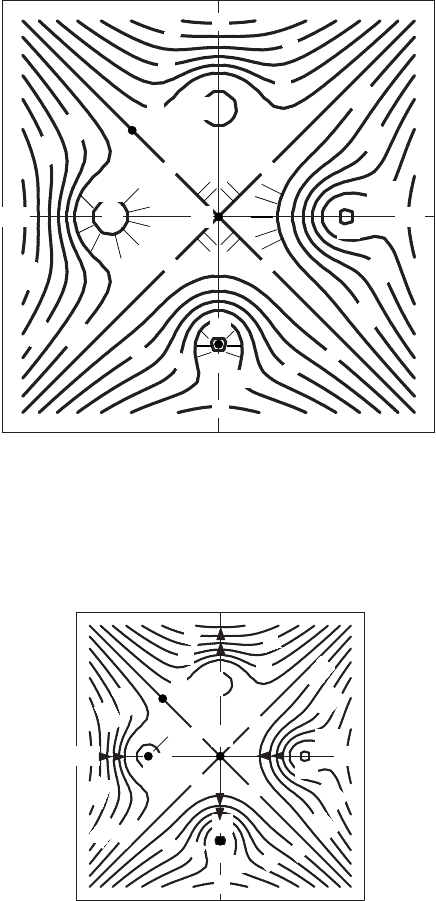
1392 Chapter Fifteen /SOLUTIONS
26. Figure 15.1 shows the gradient vectors around Pand Qpointing perpendicular to the contours and in the direction of
increasing values of the function.
y
x
0 0
0 0
1
2
3
4
5
6
11
2
3
4
5
6
6
−1
−1
−2
−3
−4
−5
−6
−1
−2
−3
−4
−5
−6−6
Q
R
P
S
✒
✿
③
❘
❲
☛
✙
■❨
✐
✛
✮
✙
■
■
✠
✠
✒
✒
❘
❘
✐✶ ✛✲
❘ ✠
Figure 15.1
27. Figure 15.2 shows the direction of ∇fat the points where k∇fkis largest, since at those points the contours are closest
together.
y
x
0 0
0 0 1
2
3
4
5
6
11
2
3
4
5
6
−1
−1
−2
−3
−4
−5
−6
−1
−2
−3
−4
−5
−6−6
Q
✠R
P
S
Figure 15.2
28. First, we identify the critical points. The partials are fx(x, y) = 3x2and fy(x, y) = −2ye−y2. These will vanish
simultaneously when x= 0 and y= 0, so our only critical point is (0,0). The discriminant is
D=fxx(x, y)fyy (x, y)−f2
xy (x, y) = (6x)(4y2e−y2−2e−y2)−0= 12xe−y2(2y2−1).
Unfortunately, the discriminant is zero at the origin so the second derivative test can tell us nothing about our critical point.
We can, however, see that we are at a saddle point by looking at the behavior of f(x, y)along the line y= 0. Here we have
f(x, 0) = x3+ 1, so for positive x, we have f(x, 0) >1 = f(0,0) and for negative x, we have f(x, 0) <1 = f(0,0).
So f(x, y)has neither a maximum nor a minimum at (0,0).

15.1 SOLUTIONS 1393
29. At a critical point,
fx= cos xsin y= 0 so cos x= 0 or sin y= 0;
and
fy= sin xcos y= 0 so sin x= 0 or cos y= 0.
Case 1: Assume cos x= 0. This gives
x=··· − 3π
2,−π
2,π
2,3π
2,···
(This can be written more compactly as: x=kπ +π/2, for k= 0,±1,±2,···.)
If cos x= 0, then sin x=±16= 0. Thus in order to have fy= 0 we need cos y= 0, giving
y=··· − 3π
2,−π
2,π
2,3π
2,···
(More compactly, y=lπ +π/2, for l= 0,±1,±2,···)
Case 2: Assume sin y= 0. This gives
y=·· · − 2π, −π, 0, π, 2π, ···
(More compactly, y=lπ, for l= 0,±1,±2,···)
If sin y= 0, then cos y=±16= 0, so to get fy= 0 we need sin x= 0, giving
x=···,−2π, −π, 0, π, 2π, ···
(More compactly, x=kπ for k= 0,±0,±1,±2,···)
Hence we get all the critical points of f(x, y). Those from Case 1 are as follows:
···−π
2,−π
2,−π
2,π
2,−π
2,3π
2···
···π
2,−π
2,π
2,π
2,π
2,3π
2···
···3π
2,−π
2,3π
2,π
2,3π
2,3π
2···
Those from Case 2 are as follows:
···(−π, −π),(−π, 0),(−π, π),(−π, 2π)···
···(0,−π),(0,0),(0, π),(0,2π)···
···(π, −π),(π, 0),(π, π),(π, 2π)···
More compactly these points can be written as,
(kπ, lπ),for k= 0,±1,±2,···, l = 0,±1,±2,···
and (kπ +π
2, lπ +π
2),for k= 0,±1,±2,···, l = 0,±1,±2,···
To classify the critical points, we find the discriminant. We have
fxx =−sin xsin y, fyy =−sin xsin y, and fxy = cos xcos y.
Thus the discriminant is
D(x, y) = fxxfyy −f2
xy
= (−sin xsin y)(−sin xsin y)−(cos xcos y)2
= sin2xsin2y−cos2xcos2y
= sin2y−cos2x. (Use: sin2x= 1 −cos2xand factor.)
At points of the form (kπ, lπ)where k= 0,±1,±2,···;l= 0,±1,±2,···, we have
D(x, y) = −1<0so (kπ, lπ)are saddle points.
At points of the form (kπ +π
2, lπ +π
2)where k= 0,±1,±2,···;l= 0,±1,±2,···
D(kπ +π
2, lπ +π
2) = 1 >0,so we have two cases:
If kand lare both even or kand lare both odd, then
fxx =−sin xsin y=−1<0, so (kπ +π
2, lπ +π
2)are local maximum points.
If kis even but lis odd or kis odd but lis even, then
fxx = 1 >0so (kπ +π
2, lπ +π
2)are local minimum points.

1394 Chapter Fifteen /SOLUTIONS
30. To find critical points, set partial derivatives equal to zero:
fx= sin x= 0 when x= 0,±π, ±2π, ···
fy=y= 0 when y= 0.
The critical points are
···(−2π, 0),(−π, 0),(0,0),(π, 0),(2π, 0),(3π, 0) ···
To classify, calculate D=fxxfyy −(fxy )2= cos x.
At the points (0,0),(±2π, 0),(±4π, 0),(±6π, 0),···
D= (1) >0and fxx >0 (Sincefxx(0,2kπ) = cos(2kπ) = 1).
Therefore (0,0),(±2π, 0),(±4π, 0),(±6π, 0),···are local minima.
At the points (±π, 0),(±3π, 0),(±5π, 0),(±7π, 0),···, we have cos(2k+ 1)π=−1, so
D= (−1) <0.
Therefore (±π, 0),(±3π, 0),(±5π, 0),(±7π, 0),···are saddle points.
31. To find the critical points, we must solve the equations
∂f
∂x =ex(1 −cos y) = 0
∂f
∂y =ex(sin y) = 0.
The first equation has solution
y= 0,±2π, ±4π,....
The second equation has solution
y= 0,±π, ±2π, ±3π, . . . .
Since xcan be anything, the lines
y= 0,±2π, ±4π,...
are lines of critical points.
We calculate
D= (fxx)(fyy )−(fxy )2=ex(1 −cos y)excos y−(exsin y)2
=e2x(cos y−cos2y−sin2y)
=e2x(cos y−1)
At any critical point on one of the lines y= 0,y=±2π,y=±4π,...,
D=e2x(1 −1) = 0.
Thus, Dtells us nothing. However, all along these critical lines, the value of the function, f, is zero. Since the function f
is never negative, the critical points are all both local and global minima.
32. (a) (1,3) is a critical point. Since fxx >0and the discriminant
D=fxxfyy −f2
xy =fxxfyy −02=fxxfyy >0,
the point (1,3) is a minimum.
(b) See Figure 15.3.
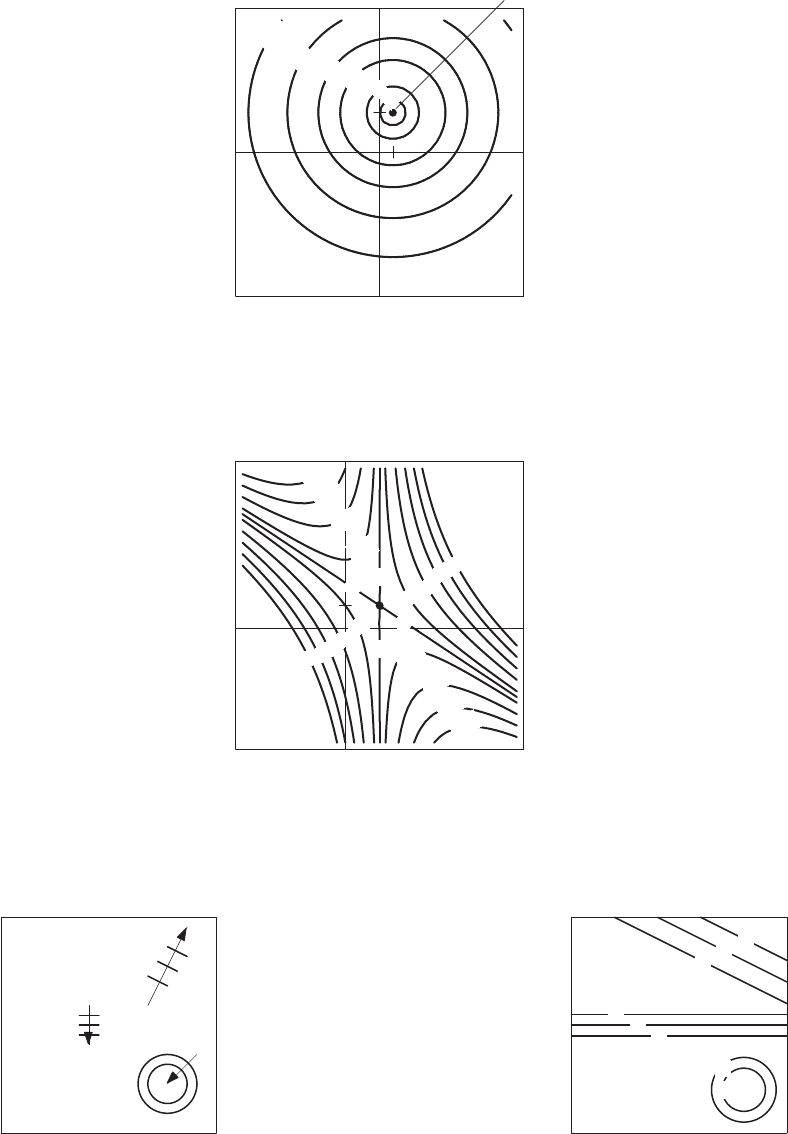
15.1 SOLUTIONS 1395
1
3
x
y
✠
0
1
4
16
32
64
120
Figure 15.3
33. (a) (a, b)is a critical point. Since the discriminant D=fxxfyy −f2
xy =−f2
xy <0,(a, b)is a saddle point.
(b) See Figure 15.4.
1
1
x
y
0
0
0
0
1
3
5
7
9
1
3
5
7
9
−1
−3
−5
−7
−1
−3
−5
−7
Figure 15.4
34. Begin by constructing little pieces of the contour diagram around each of the points (−1,0),(3,3), and (3,−3) where
some information about fis given. The general shape will be as in Figure 15.5, and the directions of increasing contour
values are indicated for each part. Then complete the diagram in any way. One possible solution is given in Figure 15.6.
Figure 15.5
: Part of contour
diagram with arrows showing
direction of increasing
function values
012
012
3
4
Figure 15.6
: Contour diagram
of f(x, y)
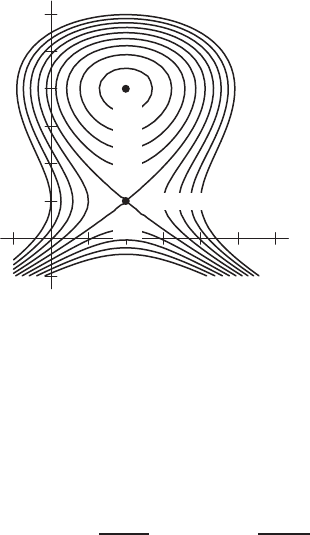
1396 Chapter Fifteen /SOLUTIONS
35. Since (2,4) is a local minimum, the contours around (2,4) are closed curves with increasing values as we go away from
the point (2,4). We assume that the function values continue to increase as we move parallel to the y-axis to the point
(2,1). Since (2,1) is a saddle point, we draw the contours so that the values go down as we move up or down from this
point, and up as we move to the left or right. One possible contour diagram is shown in Figure 15.7.
−1 123456
−1
1
2
3
4
5
6
0
1 2 3 4
−1
−1
−2
−3
−4
x
y
Figure 15.7
36. (a) We set partial derivatives to zero:
fx= 2ax −2y−4 = 0
fy= 2by −2x−6 = 0.
So we have ax −y= 2 and −x+by = 3, leading to
x=2b+ 3
ab −1and y=3a+ 2
ab −1.
(b) The discriminant is given by
D= (fxx) (fyy )−(fxy )2= (2a)(2b)−22= 4(ab −1)
If a=b= 2, then D= 4(2 ·2−1) = 12. Since fxx = 4 >0, the critical point is a local minimum.
(c) We use the fact that D= 4(ab −1) and fxx = 2a.
If a > 0and ab > 1, then D > 0and fxx >0so we have a local minimum.
If a < 0and ab > 1, then D > 0and fxx >0so we have a local maximum.
If ab < 1, then D < 0so we have a saddle point.
37. (a) Setting the partial derivatives equal to 0, we have
fx(x, y) = 2x(x2+y) + 2x(x2−y) = 4x3= 0
fy(x, y) = −(x2+y) + (x2−y) = −2y= 0.
Thus, (0,0) is the only critical point.
(b) Calculating Dgives
D= (fxx)(fyy )−(fxy)2= (12x2)(−2) −02=−24x2.
At x= 0, y = 0, we have
D(0,0) = 0.
Thus the second derivative test tells us nothing about the nature of the critical point.
(c) Since f(0,0) = 0, we sketch contours with values near 0. The contour f= 0 is given by
(x2−y)(x2+y) = 0,
that is, the two parabolas
y=x2and y=−x2
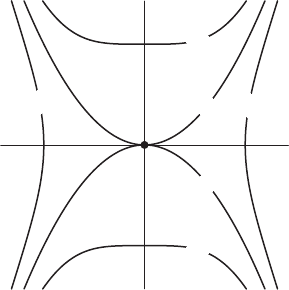
15.1 SOLUTIONS 1397
We also sketch the contours f= 1 and f=−1. See Figure 15.8.
Since there are values of the function which are both positive (above f(0,0)) and negative (below (f(0,0)),
near the critical point (0,0), the origin is neither a local maximum nor a local minimum; it is a saddle point.
f=−1
f=−1
f= 0
f= 0
f= 1
f= 1
(0,0)
x
y
Figure 15.8
38. The first order partial derivatives are
fx(x, y) = 2kx −2yand fy(x, y) = 2ky −2x.
And the second order partial derivatives are
fxx(x, y) = 2k fxy (x, y) = −2fyy (x, y) = 2k
Since fx(0,0) = fy(0,0) = 0, the point (0,0) is a critical point. The discriminant is
D= (2k)(2k)−4 = 4(k2−1).
For k=±2, the discriminant is positive, D= 12. When k= 2,fxx(0,0) = 4 which is positive so we have a local
minimum at the origin. When k=−2,fxx(0,0) = −4so we have a local maximum at the origin. In the case k= 0,
D=−4so the origin is a saddle point.
Lastly, when k=±1the discriminant is zero, so the second derivative test can tell us nothing. Luckily, we can factor
f(x, y)when k=±1. When k= 1,
f(x, y) = x2−2xy +y2= (x−y)2.
This is always greater than or equal to zero. So f(0,0) = 0 is a minimum and the surface is a trough-shaped parabolic
cylinder with its base along the line x=y.
When k=−1,
f(x, y) = −x2−2xy −y2=−(x+y)2.
This is always less than or equal to zero. So f(0,0) = 0 is a maximum. The surface is a parabolic cylinder, with its top
ridge along the line x=−y.
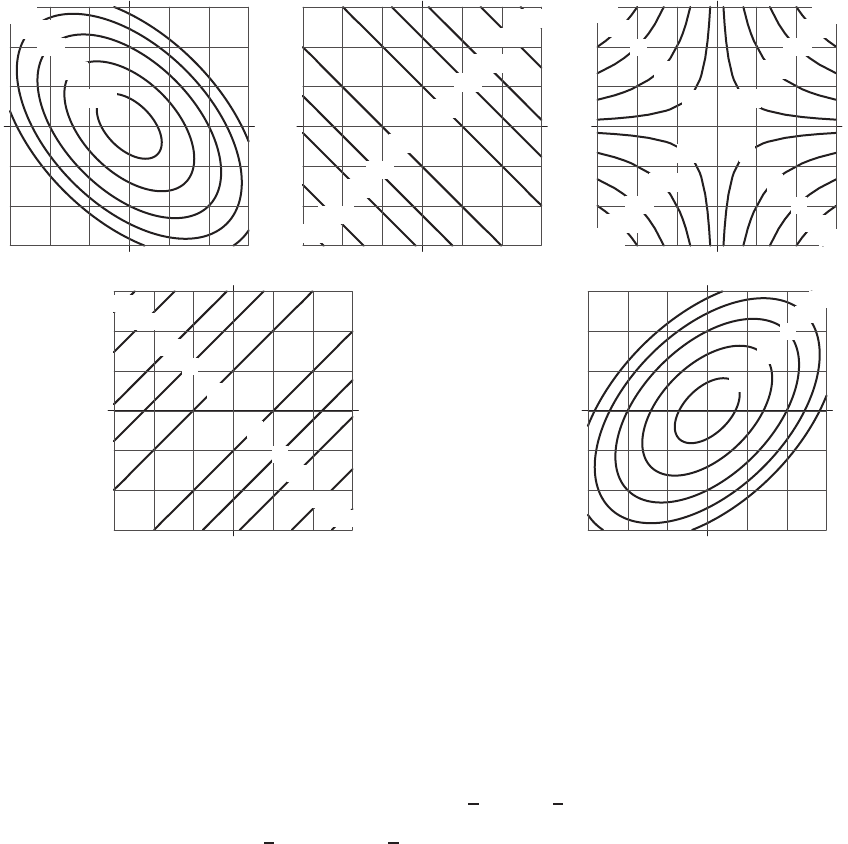
1398 Chapter Fifteen /SOLUTIONS
−1
−4
−8
−12
−16
y
x
k=−2
−1
−1
−5
−5
−10
−10
−20
−20
−30
−30
k=−1
x
yk= 0
−1
−1
−4
−4
−8
−8
−12
−12
−16
−16
4
4
8
8
12
12
16
16
1
1
x
y
1
1
5
5
10
10
20
20
30
30
k=1
x
y
1
4
8
12
16
y
x
k= 2
Figure 15.9
39. The partial derivatives are
fx(x, y) = 3x2−3y2and fy(x, y) = −6xy.
Now fx(x, y)will vanish if x=±yand fy(x, y)will vanish if either x= 0 or y= 0. Since the partial derivatives
are defined everywhere, the only critical points are where fx(x, y)and fy(x, y)vanish simultaneously. (0,0) is the only
critical point.
To find the contour for f(x, y) = 0, we solve the equation x3−3xy2= 0. This can be factored into
f(x, y) = x(x−√3y)(x+√3y) = 0
whose roots are x= 0,x=√3yand x=−√3y. Each of these roots describes a line through the origin; the three of
them divide the plane into six regions. Crossing any one of these lines will change the sign of only one of the three factors
of f(x, y), which will change the sign of f(x, y).

15.1 SOLUTIONS 1399
−2
−121
0
0
−1−2
0
1
1
2
0
−1
−2
0
1
1
2
✛y=x/√3
✛y=−x/√3
f > 0f < 0
f < 0f > 0
f > 0f < 0
x
y
Figure 15.10
40. Contours near a local extremum are approximate ellipses and contours near a saddle point are approximate hyperbolas.
The functions in the contour plots (a) and (b) have a local extremum at the origin; those in (c) and (d) have a saddle point
at the origin.
All four functions have value zero at the critical point at the origin. Graph (I) corresponds to a local maximum,
because the values near the origin are all below zero. Graph (III) corresponds to a local minimum, because the values near
the origin are all above zero. Graphs (II) and (IV) correspond to saddle points because there are both positive and negative
values near the critical point at the origin.
Contour plot (a) shows that on circles centered at the origin, ztakes values farther from zero at θ=π/2and
θ= 3π/2than at θ= 0 and θ=π. Thus (a) matches (III), and the critical point at the origin is a local minimum.
The function represented by Contour plot (b) takes values farther from zero at θ= 0 and θ=πthan at θ=π/2and
θ= 3π/2, so corresponds to (I) and has a local maximum at the origin.
The function in Contour plot (c) has value zero on the asymptotes of the hyperbolas, which are at θ=π/4,3π/4,
5π/4and 7π/4. This matches Graph (II), which represents a saddle point.
The function in Contour plot (d) has value zero on the asymptotes of the hyperbolas, which are at θ= 0,π/2,πand
3π/2. This matches Graph (IV),which represents a saddle point.
Strengthen Your Understanding
41. If fx=fy= 0 at (1,3), then (1,3) is a critical point of f. However, (1,3) may be a saddle point and not a local
maximum or minimum.
42. If D= 0 at (a, b), the point (a, b)can be a maximum, a minimum, or a saddle point. We are only sure that (a, b)is a
saddle point if D < 0.
43. If both cross-sections are concave up, then fxx(a, b)>0and fyy (a, b)>0, but we could still have D < 0when
fxy (a, b)is large enough, giving a saddle point.
For example, let f(x, y) = x2+y2+ 7xy. Then (0,0) is a critical point. We have fxx(0,0) = fyy(0,0) = 2 >0,
but fxy (0,0) = 7, so D= (2)(2) −72<0.
44. Let f(x, y) = exThen fx=ex, which is never 0.
45. The function f(x, y) = 4 −(x−2)2−(y+ 3)2has a local maximum at (2,−3,4).
46. True. By definition, a critical point is either where the gradient of fis zero or does not exist.
47. False. The point P0could be a saddle point of f.
48. False. The point P0could be a saddle point of f.
49. True. If P0were not a critical point of f, then grad f(P0)would point in the direction of maximum increase of f, which
contradicts the fact that P0is a local maximum or minimum.
50. True. The graph of this function is a cone that opens upward with its vertex at the origin.

1400 Chapter Fifteen /SOLUTIONS
51. False. The graph of this function is a saddle shape, with a saddle point at the origin. The function increases in the ~
i
direction and decreases in the ~
jdirection.
52. True. Adding 5 to the function shifts the graph 5 units vertically, which leaves the (x, y)coordinates of the local extrema
intact.
53. True. Multiplying by −1turns the graph of fupside down, so local maxima become local minima and vice-versa.
54. False. For example, the linear function f(x, y) = x+yhas no local extrema at all.
55. False. The statement is only true for points sufficiently close to P0.
56. False. Local maxima are only high points for fwhen compared to nearby values; the global maximum is the largest of
any values of fover its entire domain.
Solutions for Section 15.2
Exercises
1. Mississippi lies entirely within a region designated as 80s so we expect both the maximum and minimum daily high
temperatures within the state to be in the 80s. The southwestern-most corner of the state is close to a region designated as
90s, so we would expect the temperature here to be in the high 80s, say 87-88. The northern-most portion of the state is
located near the center of the 80s region. We might expect the high temperature there to be between 83-87.
Alabama also lies completely within a region designated as 80s so both the high and low daily high temperatures
within the state are in the 80s. The southeastern tip of the state is close to a 90s region so we would expect the temperature
here to be about 88-89 degrees. The northern-most part of the state is near the center of the 80s region so the temperature
there is 83-87 degrees.
Pennsylvania is also in the 80s region, but it is touched by the boundary line between the 80s and a 70s region. Thus
we expect the low daily high temperature to occur there and be about 80 degrees. The state is also touched by a boundary
line of a 90s region so the high will occur there and be 89-90 degrees.
New York is split by a boundary between an 80s and a 70s region, so the northern portion of the state is likely to be
about 74-76 while the southern portion is likely to be in the low 80s, maybe 81-84 or so.
California contains many different zones. The northern coastal areas will probably have the daily high as low as
65-68, although without another contour on that side, it is difficult to judge how quickly the temperature is dropping off
to the west. The tip of Southern California is in a 100s region, so there we expect the daily high to be 100-101.
Arizona will have a low daily high around 85-87 in the northwest corner and a high in the 100s, perhaps 102-107 in
its southern regions.
Massachusetts will probably have a high daily high around 81-84 and a low daily high of 70.
2. The maximum value, which is about 11, occurs at (5.1,4.9). The minimum value, which is about −1, occurs at (1,3.9).
3. The maximum value, which is slightly above 30, say 30.5, occurs approximately at the origin. The minimum value, which
is about 20.5, occurs at (2.5,5).
4. The maxima occur at about (π/2,0) and (π/2,2π). The minimum occurs at (π/2, π). The maximum value is about 1,
the minimum value is about −1.
5. To maximize z=x2+y2, it suffices to maximize x2and y2. We can maximize both of these at the same time by
taking the point (1,1), where z= 2. It occurs on the boundary of the square. (Note: We also have maxima at the points
(−1,−1),(−1,1) and (1,−1) which are on the boundary of the square.)
To minimize z=x2+y2, we choose the point (0,0), where z= 0. It does not occur on the boundary of the square.
6. To maximize z=−x2−y2it suffices to minimize x2and y2. Thus, the maximum is at (0,0), where z= 0. It does not
occur on the boundary of the square.
To minimize z=−x2−y2, it suffices to maximize x2and y2. Do this by taking the point (1,1),(−1,−1),(−1,1),
or (1,−1) where z=−2. These occur on the boundary of the square.
7. To maximize this function, it suffices to maximize x2and minimize y2. We can do this by choosing the point (1,0), or
(−1,0) where z= 1. These occur on the boundary of the square.
To minimize z=x2−y2, it suffices to maximize y2and minimize x2. We can do this by taking the point (0,1), or
(0,−1) where z=−1. These occur on the boundary of the square.
8. The function fhas no global maximum or global minimum.
9. The function ghas a global minimum (it is 0) but no global maximum.
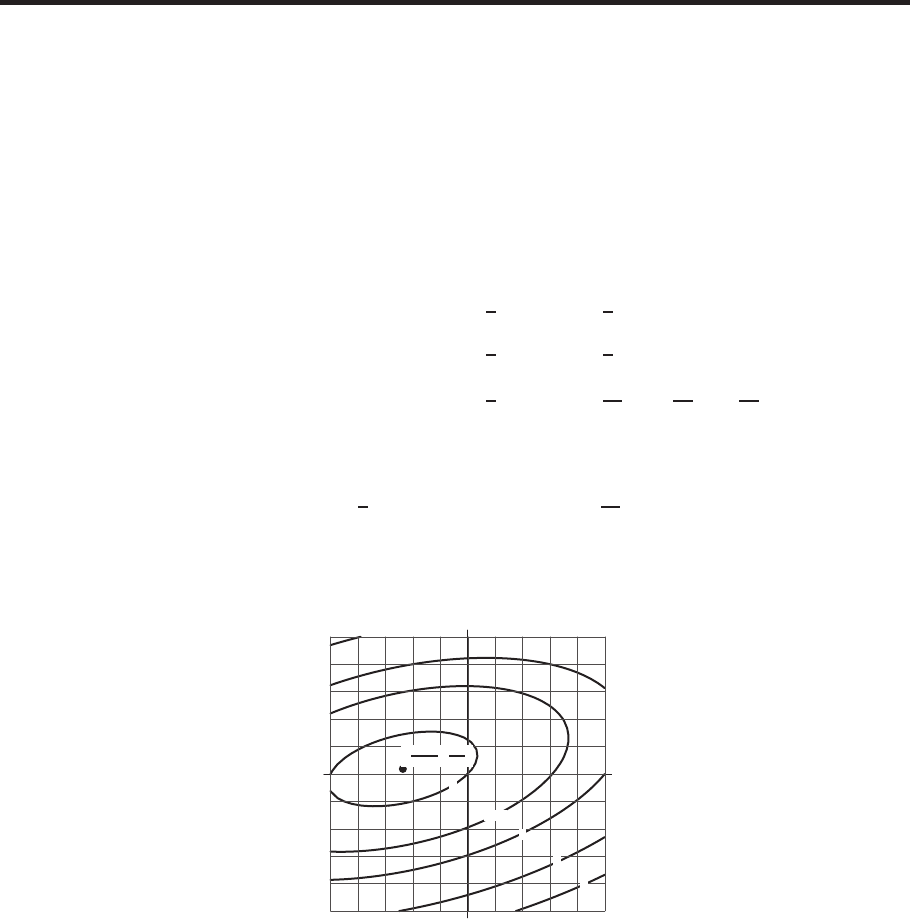
15.2 SOLUTIONS 1401
10. The function hhas no global maximum or minimum.
11. Since f(x, y)≤0for all x, y and sincef(0,0) = 0, the function has a global maximum (it is 0) and no global minimum.
12. Suppose xis fixed. Then for large values of ythe sign of fis determined by the highest power of y, namely y3. Thus,
f(x, y)→ ∞ as y→ ∞
f(x, y)→ −∞ as y→ −∞.
So fdoes not have a global maximum or minimum.
Problems
13. (a) The critical points of fare the point(s) at which the partial derivatives, fxand fy, are zero. We have
fx= 4x−3y+ 1
fy=−3x+ 16y−1.
Solving the linear system fx= 0,fy= 0, we find (x, y) = (−13/55,1/55). To classify this point, we have to find
the sign of fxx ·fyy −f2
xy there. We calculate
fxx ·fyy −f2
xy = 4 ·16 −9 = 55 >0.
Thus, (−13/55,1/55) is a local minimum.
(b) We complete the square in the following way:
2x2−3xy + 8y2+x−y= 2x2−x(3y−1) + 8y2−y
= 2(x−1
4(3y−1))2−1
8(3y−1)2+ 8y2−y
= 2(x−1
4(3y−1))2+1
8(55y2−2y−1)
= 2(x−1
4(3y−1))2+55
8y−1
55 2
−7
55 .
Therefore the function has a global minimum located at the point (x, y)where both the two squares vanish. The
coordinates of that point satisfy:
x−1
4(3y−1) = 0 and y−1
55 = 0.
The two conditions again give the point (x, y) = (−13/55,1/55). The contour diagram for fis shown in Fig-
ure 15.11. The fact that fcan be written in this way as the sum of two squares shows that the point (x, y) =
(−13/55,1/55) is a global minimum.
(−13
55 ,1
55 )
0
0.5
1
2
3
0.5
0.5
-
0.5
Figure 15.11
: The contour diagram for
f(x, y) = 2x2−3xy + 8y2+x−y

1402 Chapter Fifteen /SOLUTIONS
14. We calculate the partial derivatives and set them to zero.
∂(range)
∂t =−10t−6h+ 400 = 0
∂(range)
∂h =−6t−6h+ 300 = 0.
10t+ 6h= 400
6t+ 6h= 300
Solving, we obtain
4t= 100
so
t= 25
Solving for h, we obtain 6h= 150, yielding h= 25. Since the range is quadratic in hand t, the second derivative test
tells us this is a local and global maximum. So the optimal conditions are h= 25% humidity and t= 25◦C.
15. Let the sides be x, y, z cm. Then the volume is given by V=xyz = 32.
The surface area Sis given by
S= 2xy + 2xz + 2yz.
Substituting z= 32/(xy)gives
S= 2xy +64
y+64
x.
At a critical point,
∂S
∂x = 2y−64
x2= 0
∂S
∂y = 2x−64
y2= 0,
The symmetry of the equations (or by dividing the equations) tells us that x=yand
2x−64
x2= 0
x3= 32
x= 321/3= 3.17 cm.
Thus the only critical point is x=y= (32)1/3cm and z= 32/(32)1/3·(32)1/3= (32)1/3cm. At the critical point
SxxSyy −(Sxy )2=128
x3·128
y3−22=(128)2
x3y3−4.
Since D > 0and Sxx >0at this critical point, the critical point x=y=z= (32)1/3is a local minimum. Since
S→ ∞ as x, y → ∞, the local minimum is a global minimum.
16. If the coordinates of the corner on the plane are (x, y, z), the volume of the box is V=xyz. Since z= 1 −3x−2yon
the plane, the volume is given by
V=xy(1 −3x−2y) = xy −3x2y−2xy2.
The domain is the triangular region 0≤x≤1
3,0≤y≤(1 −3x)/2. At a critical point,
∂V
∂x =y−6xy −2y2=y(1 −6x−2y) = 0
∂V
∂y =x−3x2−4xy =x(1 −3x−4y) = 0,
One solution is x=y= 0. Another is x= 0, y =1
2; another is y= 0, x =1
3. Another is the solution of
1−6x−2y= 0
1−3x−4y= 0,
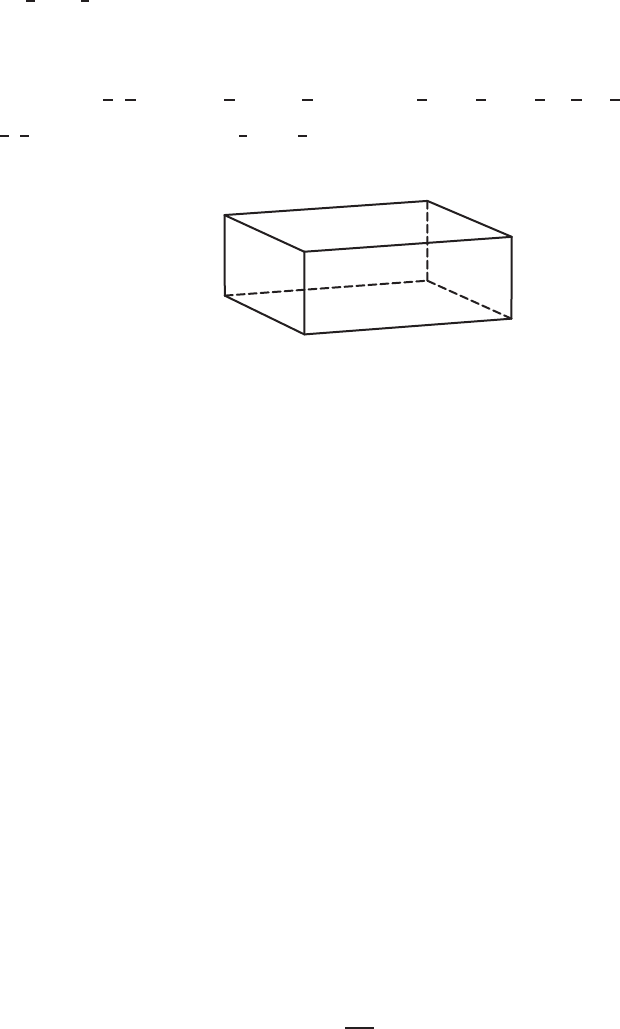
15.2 SOLUTIONS 1403
namely x=1
9, y =1
6.
If either x= 0 or y= 0, then V= 0, so these solutions do not give the maximum volume. Since
D=VxxVyy −(Vxy )2= (−6y)(−4x)−(1 −6x−4y)2
D1
9,1
6=−6·1
6−4·1
9−1−6·1
9−4·1
62
=4
9−1
9=1
3>0,
and Vxx(1
9,1
6) = −1<0, the point x=1
9, y =1
6, is a local maximum at which V= (1/9)(1/6) −3(1/9)2(1/6) −
2(1/9)(1/6)2= 1/162.
Since all points on the boundary of the domain give V= 0, the local maximum is a global maximum.
17.
w
l
h
Figure 15.12
Let w,hand lbe width, height and length of the suitcase in cm. Then its volume V=lwh, and w+h+l≤135.
To maximize the volume V, choose w+h+l= 135, and thus l= 135 −w−h,
V=wh(135 −w−h)
= 135wh −w2h−wh2
Differentiating gives
Vw= 135h−2wh −h2,
Vh= 135w−w2−2wh.
Find the critical points by solving Vw= 0 and Vh= 0:
Vw= 0 gives 135h−h2= 2wh,
Vh= 0 gives 135w−w2= 2wh.
As hw 6= 0, we cancel h(and wrespectively) in the above equations and get
135 −h= 2w
135 −w= 2h
Subtracting gives
w−h= 2(w−h)
hence w=h. Therefore, substituting into the equation Vw= 0
135h−h2= 2h2
and therefore
3h2= 135h.
Since h6= 0, we have
h=135
3= 45.
So w=h= 45 cm. Thus, l= 135 −w−h= 45 cm. To check that this critical point is a maximum, we find
Vww =−2h, Vhh =−2w,
Vwh = 135 −2w−2h,
so
D=Vww Vhh −V2
wh = 4hw −(135 −2w−2h)2.
At w=h= 45, we have Vww =−2(45) <0and D= 4(45)2−(135 −90 −90)2= 6075 >0, hence Vis maximum
at w=h=l= 45.
Therefore, the suitcase with maximum volume is a cube with dimensions width =height =length = 45 cm.

1404 Chapter Fifteen /SOLUTIONS
18. The box is shown in Figure 15.13. Cost of four sides = (2hl + 2wh)(1)c/. Cost of two bottoms = (2wl)(2)c/. Thus the
total cost C(in cents) of the box is
C= 2(hl +wh) + 4wl.
But volume wlh = 512, so l= 512/(wh), thus
C=1024
w+ 2wh +2048
h.
To minimize C, find the critical points of Cby solving
Ch= 2w−2048
h2= 0,
Cw= 2h−1024
w2= 0.
We get
2wh2= 2048
2hw2= 1024.
Since w,h6= 0, we can divide the first equation by the second giving
2wh2
2hw2=2048
1024 ,
so h
w= 2,
thus
h= 2w.
Substituting this in Ch= 0, we obtain h3= 2048, so h= 12.7cm. Thus w=h/2 = 6.35 cm, and l= 512/(wh) =
6.35 cm. Now we check that these dimensions minimize the cost C. We find that
D=ChhCww −C2
hw = ( 4096
h3)( 2048
w3)−22,
and at h= 12.7,w= 6.35,Chh >0and D= 16 −4>0, thus Chas a local minimum at h= 12.7and w= 6.35.
Since Cincreases without bound as w, h →0or ∞, this local minimum must be a global minimum.
Therefore, the dimensions of the box that minimize the cost are w= 6.35 cm, l= 6.35 cm and h= 12.7cm.
w
l
h
Figure 15.13
19. The square of the distance from the point (x, y, z)to the origin is
S=x2+y2+z2.
If the point is on the plane, z= 1 −3x−2y, we have
S=x2+y2+ (1 −3x−2y)2.
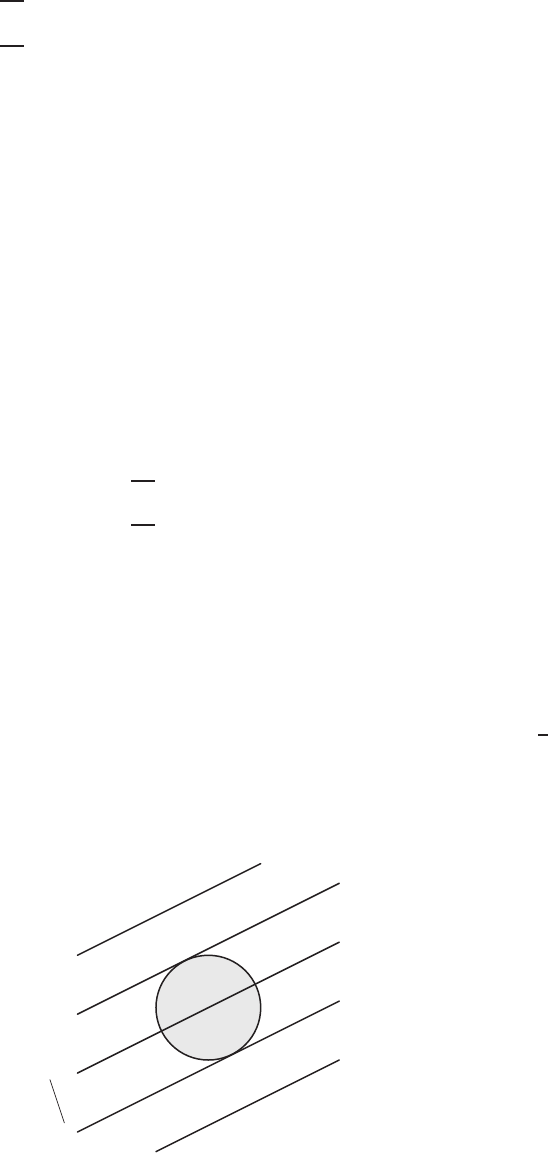
15.2 SOLUTIONS 1405
At the critical point
∂S
∂x = 2x+ 2(1 −3x−2y)(−3) = 2(10x+ 6y−3) = 0
∂S
∂y = 2y+ 2(1 −3x−2y)(−2) = 2(6x+ 5y−2) = 0.
Simplifying gives
10x+ 6y= 3
6x+ 5y= 2,
with solution x= 3/14, y = 1/7. At this point z= 1/14. We have
D=SxxSyy −(Sxy )2= (20)(10) −122= 56,
so D > 0and Sxx >0. Thus, the point x= 3/14, y = 1/7is a local minimum. Since S→ ∞ as x, y → ±∞, the local
minimum is a global minimum. Thus, x= 3/14, y = 1/7, z = 1/14 is the closest point to the origin on the plane.
20. We minimize the square of the distance from the point (x, y, z)to the origin:
S=x2+y2+z2.
Since z2= 9 −xy −3x, we have
S=x2+y2+ 9 −xy −3x.
At a critical point
∂S
∂x = 2x−y−3 = 0
∂S
∂y = 2y−x= 0,
so x= 2y, and
2(2y)−y−3 = 0
giving y= 1, so x= 2 and z2= 9 −2·1−3·2 = 1, so z=±1. We have
D=SxxSyy −(Sxy )2= 2 ·2−(−1)2= 4 −1>0,
so, since D > 0and Sxx >0, the critical points are local minima. Since S→ ∞ as x, y → ±∞, the local minima are
global minima.
If x= 2, y = 1, z =±1, we have S= 22+ 12+ 12= 6, so the shortest distance to the origin is √6.
21. (a) We draw the level curves (parallel straight lines) of f(x, y) = ax +by +c. We can see that the level lines with the
maximum and minimum f-values which intersect with the disk are the level lines that are tangent to the boundary of
the disk. Therefore, the maximum and minimum occur at the boundary of the disk. See Figure 15.14.
f=
max
f=
min
f
increases
▼
Figure 15.14
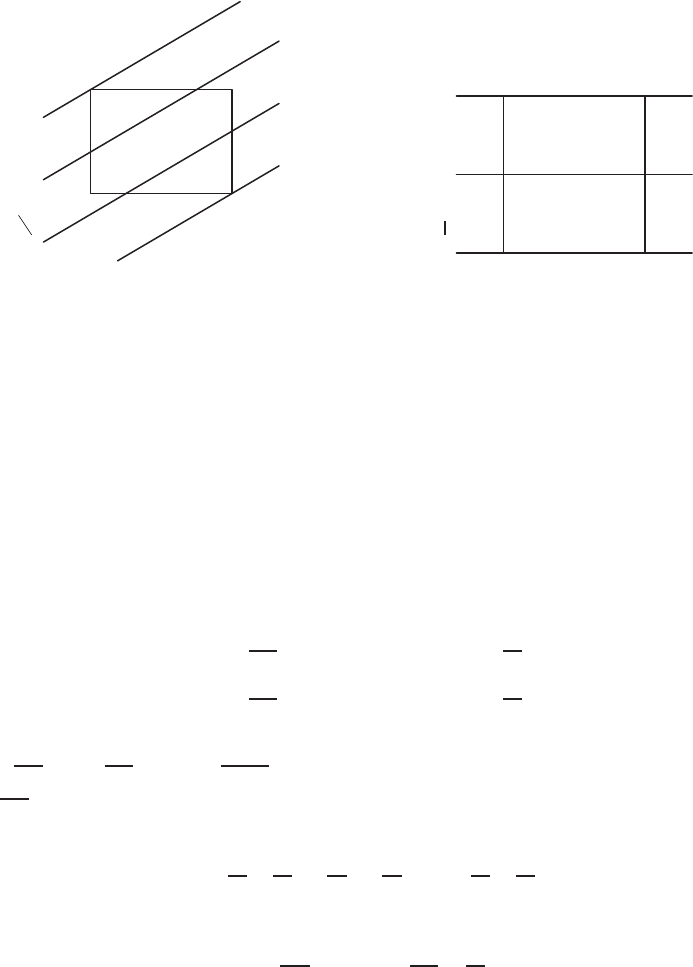
1406 Chapter Fifteen /SOLUTIONS
f=
max
f=
min
f
increases
❪
Figure 15.15
f=
max
f=
min
f
increases
✻
Figure 15.16
(b) Similar to part (a), we see the level lines with the largest and smallest f-values which intersect with the rectangle must
pass the corner of the rectangle. So the maximum and minimum occur at the corners of rectangle. See Figure 15.15.
When the level curves are parallel to a pair of the sides, then the points on the sides are all maximum or minimum, as
shown below in Figure 15.16.
(c) The graph of fis a plane. The part of the graph lying above a disk Ris either a flat disk, in which case every point is
a maximum, or is a tilted ellipse, in which case you can see that the maximum will be on the edge. Similarly, the part
lying above a rectangle is either a rectangle or a tilted parallelogram, in which case the maximum will be at a corner.
22. (a) The revenue R=p1q1+p2q2. Profit =P=R−C=p1q1+p2q2−2q2
1−2q2
2−10.
∂P
∂q1
=p1−4q1= 0 gives q1=p1
4
∂P
∂q2
=p2−4q2= 0 gives q2=p2
4
Since ∂2P
∂q2
1
=−4,∂2P
∂q2
2
=−4and ∂2P
∂q1∂q2= 0, at (p1/4, p2/4) we have that the discriminant, D= (−4)(−4) >0
and ∂2P
∂q2
1
<0, thus Phas a local maximum value at (q1, q2) = (p1/4, p2/4). Since Pis quadratic in q1and q2, this
is a global maximum. So the maximum profit is
P=p2
1
4+p2
2
4−2p2
1
16 −2p2
2
16 −10 = p2
1
8+p2
2
8−10.
(b) The rate of change of the maximum profit as p1increases is
∂
∂p1
(max P) = 2p1
8=p1
4.
23. The total revenue is
R=pq = (60 −0.04q)q= 60q−0.04q2,
and as q=q1+q2, this gives
R= 60q1+ 60q2−0.04q2
1−0.08q1q2−0.04q2
2.
Therefore, the profit is
P(q1, q2) = R−C1−C2
=−13.7 + 60q1+ 60q2−0.07q2
1−0.08q2
2−0.08q1q2.
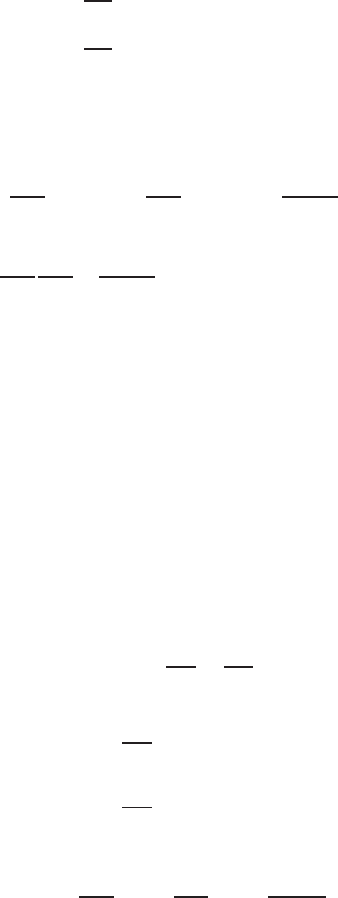
15.2 SOLUTIONS 1407
At a local maximum point, we have grad P=~
0:
∂P
∂q1
= 60 −0.14q1−0.08q2= 0,
∂P
∂q2
= 60 −0.16q2−0.08q1= 0.
Solving these equations, we find that
q1= 300 and q2= 225.
To see whether or not we have found a local maximum, we compute the second-order partial derivatives:
∂2P
∂q2
1
=−0.14,∂2P
∂q2
2
=−0.16,∂2P
∂q1∂q2
=−0.08.
Therefore,
D=∂2P
∂q2
1
∂2P
∂q2
2−∂2P
∂q1∂q2
= (−0.14)(−0.16) −(−0.08)2= 0.016,
and so we have found a local maximum point. The graph of P(q1, q2)has the shape of an upside down paraboloid since
Pis quadratic in q1and q2, hence (300,225) is a global maximum point.
24. (a) This tells us that an increase in the price of either product causes a decrease in the quantity demanded of both
products. An example of products with this relationship is tennis rackets and tennis balls. An increase in the price of
either product is likely to lead to a decrease in the quantity demanded of both products as they are used together. In
economics, it is rare for the quantity demanded of a product to increase if its price increases, so for q1, the coefficient
of p1is negative as expected. The coefficient of p2in the expression could be either negative or positive. In this case,
it is negative showing that the two products are complementary in use. If it were positive, however, it would indicate
that the two products are competitive in use, for example Coke and Pepsi.
(b) The revenue from the first product would be q1p1= 150p1−2p2
1−p1p2, and the revenue from the second product
would be q2p2= 200p2−p1p2−3p2
2. The total sales revenue of both products, R, would be
R(p1, p2) = 150p1+ 200p2−2p1p2−2p2
1−3p2
2.
Note that Ris a function of p1and p2. To find the critical points of R, set ∇R= 0, i.e.,
∂R
∂p1
=∂R
∂p2
= 0.
This gives
∂R
∂p1
= 150 −2p2−4p1= 0
and ∂R
∂p2
= 200 −2p1−6p2= 0
Solving simultaneously, we have p1= 25 and p2= 25. Therefore the point (25,25) is a critical point for R. Further,
∂2R
∂p2
1
=−4,∂2R
∂p2
2
=−6,∂2R
∂p1∂p2
=−2,
so the discriminant at this critical point is
D= (−4)(−6) −(−2)2= 20.
Since D > 0and ∂2R/∂p2
1<0, this critical point is a local maximum. Since Ris quadratic in p1and p2, this is a
global maximum. Therefore the maximum possible revenue is
R= 150(25) + 200(25) −2(25)(25) −2(25)2−3(25)2
= (6)(25)2+ 8(25)2−7(25)2
= 4375.
This is obtained when p1=p2= 25. Note that at these prices, q1= 75 units, and q2= 100 units.

1408 Chapter Fifteen /SOLUTIONS
25. Let P(K, L)be the profit obtained using Kunits of capital and Lunits of labor. The cost of production is given by
C(K, L) = kK +ℓL,
and the revenue function is given by
R(K, L) = pQ =pAKaLb.
Hence, the profit is
P=R−C=pAKaLb−(kK +ℓL).
In order to find local maxima of P, we calculate the partial derivatives and see where they are zero. We have:
∂P
∂K =apAKa−1Lb−k,
∂P
∂L =bpAKaLb−1−ℓ.
The critical points of the function P(K, L)are solutions (K, L)of the simultaneous equations:
k
a=pAKa−1Lb,
ℓ
b=pAKaLb−1.
Multiplying the first equation by Kand the second by L, we get
kK
a=ℓL
b,
and so
K=ℓa
kb L.
Substituting for Kin the equation k/a =pAKa−1Lb, we get:
k
a=pA ℓa
kb a−1
La−1Lb.
We must therefore have
L1−a−b=pA a
kaℓ
ba−1
.
Hence, if a+b6= 1,
L=pA a
kaℓ
b(a−1)1/(1−a−b)
,
and
K=ℓa
kb L=ℓa
kb pA a
kaℓ
b(a−1)1/(1−a−b)
.
To see if this is really a local maximum, we apply the second derivative test. We have:
∂2P
∂K2=a(a−1)pAKa−2Lb,
∂2P
∂L2=b(b−1)pAKaLb−2,
∂2P
∂K∂L =abpAKa−1Lb−1.
Hence,
D=∂2P
∂K2
∂2P
∂L2−∂2P
∂K∂L 2
=ab(a−1)(b−1)p2A2K2a−2L2b−2−a2b2p2A2K2a−2L2b−2
=ab((a−1)(b−1) −ab)p2A2K2a−2L2b−2
=ab(1 −a−b)p2A2K2a−2L2b−2.

15.2 SOLUTIONS 1409
Now a,b,p,A,K, and Lare positive numbers. So, the sign of this last expression is determined by the sign of 1−a−b.
(a) We assumed that a+b < 1, so D > 0, and as 0< a < 1, then ∂2P/∂K2<0and so we have a unique local
maximum. To verify that the local maximum is a global maximum, we focus on the cost. Let C=kK +ℓL. Since
K≥0and L≥0,K≤C/k and L≤C/ℓ. Therefore the profit satisfies:
P=pAKaLb−(kK +ℓL)
≤pA C
kaC
ℓb
−C
=mCa+b−C
where m=pA(1/k)a(1/ℓ)b. Since a+b < 1, the profit is negative for large costs C, say C≥C0(C0=m1−a−b
will do). Therefore, in the KL-plane for K≥0and L≥0, the profit is less than or equal to zero everywhere on or
above the line kK +ℓL =Co. Thus the global maximum must occur inside the triangle bounded by this line and the
Kand Laxes. Since P≤0on the Kand Laxes as well, the global maximum must be in the interior of the triangle
at the unique local maximum we found.
In the case a+b < 1, we have decreasing returns to scale. That is, if the amount of capital and labor used is
multiplied by a constant λ > 0, we get less than λtimes the production.
(b) Now suppose a+b≥1. If we multiply Kand Lby λfor some λ > 0, then
Q(λK, λL) = A(λK)a(λL)b=λa+bQ(K, L).
We also see that
C(λK, λL) = λC(K, L).
So if a+b= 1, we have
P(λK, λL) = λP (K, L).
Thus, if λ= 2, so we are doubling the inputs Kand L, then the profit Pis doubled and hence there can be no
maximum profit.
If a+b > 1, we have increasing returns to scale and there can again be no maximum profit: doubling the inputs
will more than double the profit. In this case, the profit increases without bound as K, L go toward infinity.
26. We have
fx= 2x(y+ 1)3= 0 only when x= 0 or y=−1
fy= 3x2(y+ 1)2+ 2y= 0 never when y=−1and only for y= 0 when x= 0
We conclude that fx= 0 and fy= 0 only when x= 0, y = 0, so fhas only one critical point, namely (0,0).
The second derivative test at (0,0) gives
D=fxxfyy −(fxy )2= 2(y+ 1)3(6x2(y+ 1) + 2) −(6x(y+ 1)2)2
= 2(1)(2) −0>0when x= 0, y = 0
Since fxx >0at (0,0), this means fhas a local minimum at (0,0).
[Alternatively, if we expand (y+ 1)3, then we can view f(x, y)as x2+y2+(terms of degree 3or greater in xand
y), which means that fbehaves likes x2+y2near (0,0).]
Although (0,0) is a local minimum, it cannot be a global minimum since for fixed x, say x= 1, the function f(x, y)
is a cubic polynomial in yand cubics take on arbitrarily large positive and negative values.
In the single-variable case, suppose a function fdefined on the real line is differentiable and its derivative is con-
tinuous. Then if fhas only one critical point, say x= 0, and if that critical point is a local minimum, it must also be a
global minimum. This is because f′cannot change sign without f′= 0 so we must have f′<0for x < 0and f′>0
for x > 0. Thus fis decreasing for all x < 0and increasing for all x > 0, so x= 0 is the global minimum for f.
27. The variables are aand b, so we set
∂S
∂a = 2(a+b) + 8(4a+b−2) + 18(9a+b−4) = 0
∂S
∂b = 2(a+b) + 2(4a+b−2) + 2(9a+b−4) = 0,
so, collecting terms and dividing by 4 and 2 respectively,
49a+ 7b−22 = 0
14a+ 3b−6 = 0.

1410 Chapter Fifteen /SOLUTIONS
Solving gives a= 24/49,b=−2/7.
Since there is only one critical point and Sis unbounded as a, b → ∞, this critical point is the global minimum.
Therefore, the best fitting parabola is
y=24
49 x2−2
7.
28. Let the line be in the form y=b+mx. Then, when xequals 0,1, and 2,yequals b,b+m, and b+ 2mrespectively.
The sum of the squares of the vertical distances, which is what we want to minimize, is
f(m, b) = (4 −b)2+ (3 −(b+m))2+ (1 −(b+ 2m))2
To find critical points, set each partial derivative equal to zero.
fm= 0 + 2(3 −(b+m))(−1) + 2(1 −(b+ 2m))(−2)
= 6b+ 10m−10
fb= 2(4 −b)(−1) + 2(3 −(b+m))(−1) + 2(1 −(b+ 2m))(−1)
= 6b+ 6m−16
Setting both partial derivatives equal to zero and dividing by 2, we get a system of equations:
3b+ 5m= 5
3b+ 3m= 8
with solutions m=−3
2and b=25
6. Thus, the line is y=25
6−3
2x.
29. (a) We have f(2,1) = 120.
(i) If x > 20 then f(x, y)>10x > 200 > f(2,1).
(ii) If y > 20 then f(x, y)>20y > 400 > f(2,1).
(iii) If x < 0.01 and y≤20 then f(x, y)>80/(xy)>80/((0.01)(20)) = 400 > f(2,1).
(iv) If y < 0.01 and x≤20 then f(x, y)>80/(xy)>80/((20)(0.01)) = 400 > f(2,1).
(b) The continuous function fmust achieve a minimum at some point (x0, y0)in the closed and bounded region R′:
0.01 ≤x≤20,0.01 ≤y≤20. Since (2,1) is in R′, we must have f(x0, y0)≤f(2,1). By part (a), f(x0, y0)
is less than all values of fin the part of Rthat is outside R′, so f(x0, y0)is a minimum for fon all of R. Since
(x0, y0)is not on the boundary of R, it must be a critical point of f.
(c) The only critical point of fin Ris the point (2,1), so by part (b) fhas a global minimum there.
30. (a) The function fis continuous in the region R, but Ris not closed and bounded so a special analysis is required.
Notice that f(x, y)tends to ∞as (x, y)tends farther and farther from the origin or tends toward any point on
the xor yaxis. This suggests that a minimum for f, if it exists, can not be too far from the origin or too close to the
axes. For example, if x > 10 then f(x, y)>4x > 40, and if y > 10 then f(x, y)>5y > 50. If 0< x < 0.1then
f(x, y)>2/x > 20, and if 0< y < 0.1then f(x, y)>3/y > 30.
Since f(1,1) = 14, a global minimum for fif it exists must be in the smaller region R′: 0.1≤x≤10,
0.1≤y≤10. The region R′is closed and bounded and so fdoes have a minimum value at some point in R′, and
since that value is at most 14, it is also a global minimum for all of R.
(b) Since the region Rhas no boundary, the minimum value must occur at a critical point of f. At a critical point we
have
fx=−2
x2+ 4 = 0 fy=−3
y2+ 5 = 0.
The only critical point is (p1/2,p3/5) ≈(0.7071,0.7746), at which fachieves the minimum value
f(p1/2,p3/5) = 4√2 + 2√15 ≈13.403.
31. (a) There is one variable, p, in this problem; P0and PFare constants. At the minimum energy,
dE
dp =2p
P2
0−2P2
F
p3= 0
p4=P2
0P2
F
p=√P0PF.
This value of pgives a minimum for Ebecause it is the only critical point and the value of Egrows toward ∞as
p→ ∞.
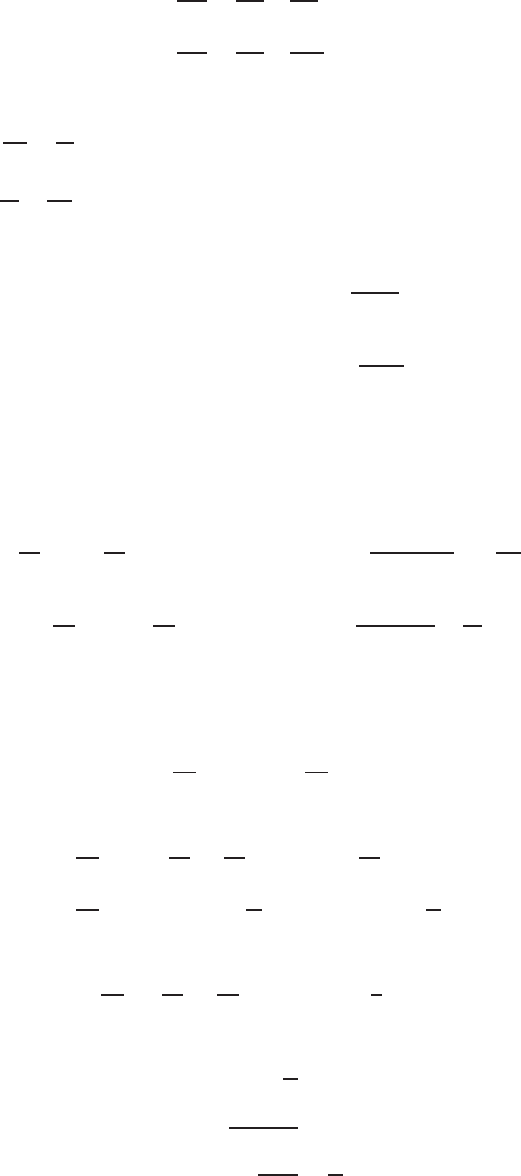
15.2 SOLUTIONS 1411
(b) There are now two variables, p1and p2, so at the minimum energy,
∂E
∂p1
=2p1
P2
0−2p2
2
p3
1
= 0
∂E
∂p2
=2p2
p2
1−2P2
F
p3
2
= 0.
Solving these equations simultaneously:
p1
P2
0
=p2
2
p3
1
,so p4
1=P2
0p2
2and taking square roots gives p2
1=P0p2.
p2
p2
1
=P2
F
p3
2
,so p4
2=P2
Fp2
1and taking square roots gives p2
2=PFp1.
Substituting p2
2=PFp1into p4
1=P2
0p2
2gives
p4
1=P2
0PFp1
p3
1=P2
0PFso p1=3
pP2
0PF.
Substituting p2
1=P0p2into p4
2=P2
Fp2
1gives
p4
2=P2
FP0p2so p2=3
pP0P2
F.
The critical value of Eis again a minimum because the critical point is unique and the value of Etends to ∞as
p1, p2→ ∞.
32. (a) Look at the formula q=Kp−Eaθ. Since price, p, has a negative exponent, when the price is increased, less is sold.
Since advertising, a, has a positive exponent, when the amount of advertising is increased, more is sold.
(b) Since q=Kp−Eaθ, we have
∂q
∂p =Kaθ∂
∂p (p−E) = Kaθ(−Ep−E−1) = −EKp−Eaθ
p=−Eq
p
and
∂q
∂a =Kp−E∂
∂a (aθ) = Kp−Eθaθ−1=θKp−Eaθ
a=θq
a.
(c) Profit is revenue minus cost. Revenue is pq. Cost is the sum of the cost cq of producing the items and the cost paaof
advertising. Hence
π=Profit =Revenue −Cost =pq −cq −paa.
(d) At maximum profit, both partial derivatives are zero:
∂π
∂p = 0 and ∂π
∂a = 0.
(e) Using π=pq −cq −paa, we have
∂π
∂p =q+p∂q
∂p −c∂q
∂p =q+ (p−c)∂q
∂p
∂π
∂p =q+ (p−c)−E
pq=q1−(p−c)E
p.
In addition
∂π
∂a =p∂q
∂a −c∂q
∂a −pa=q(p−c)θ
a−pa.
(f) At maximum profit, ∂π/∂p = 0, so solving for pgives
1−(p−c)E
p= 0
(p−c)E
p= 1
p−c
p=1
E
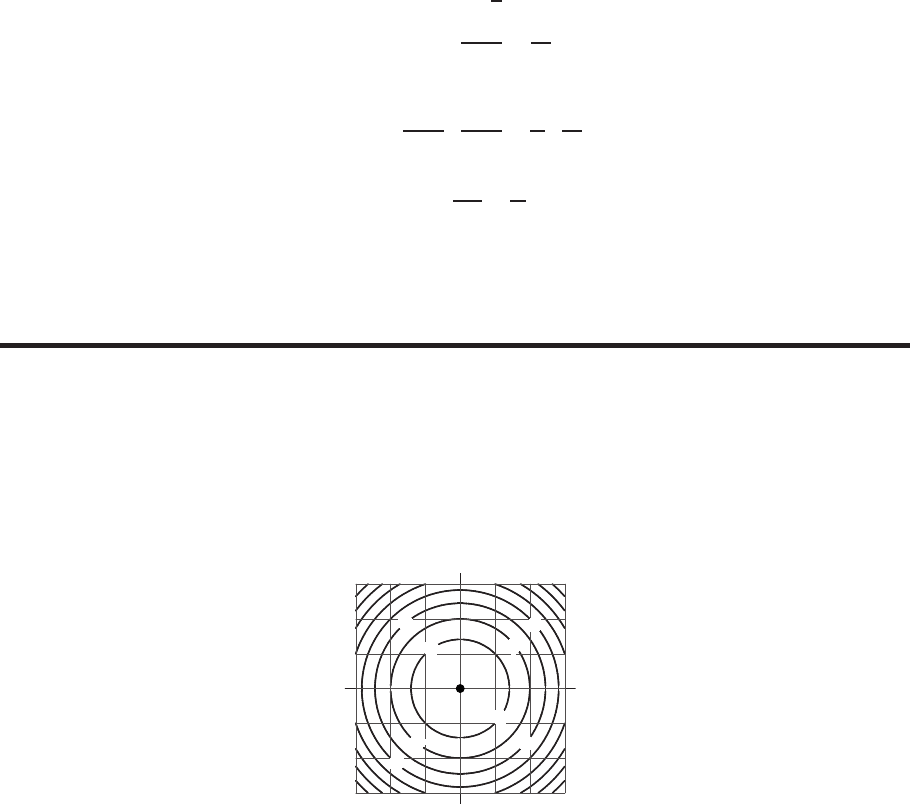
1412 Chapter Fifteen /SOLUTIONS
In addition, at maximum profit, ∂π/∂a = 0, so we have
q(p−c)θ
a=pa
p−c
pa
=a
qθ .
(g) By parts (e) and (f), at maximum profit we have
p−c
p·pa
p−c=1
E·qθ
a
and hence paa
pq =θ
E.
The numerator, paa, is the amount the company spends on advertising. The denominator, pq, is the company’s
revenue. The monopoly spends a fixed fraction, θ/E of its revenue for advertising, no matter how the price of
advertising might change.
Strengthen Your Understanding
33. If the region is closed and bounded and the function is continuous, then it must have a global maximum, even if it has no
critical points.
34. The Extreme Value Theorem does not say what happens when Ris unbounded. For example, suppose the region Ris the
whole xy-plane. Some functions may have a global minimum, such as f(x, y) = x2+y2, and others may not, such as
f(x, y) = x+y.
35. The local maximum is not necessarily the global maximum. For example, let f(x, y)be a function with the contour
diagram in Figure 15.17.
321−1−2−3
3
2
1
−1
−2
−3
x
y
1
1
1
0
0
2
2
3
3
Figure 15.17
This function has a local maximum value of 1at the origin. However, 1is definitely not the global maximum value
since the function attains higher values at other input values.
36. Let f(x, y) = x+y, which tends to +∞as x→ ∞ and tends to −∞ as x→ −∞.
37. Let f(x, y) = x2+y2and let Rbe the square 0≤x≤1,0≤y≤1. Then the maximum value of foccurs at (1,1).
38. True. For unconstrained optimization, global extrema occur at one (or more) of the local extrema.
39. False. For example, the linear function f(x, y) = x+yhas neither a global minimum or global maximum on all of
2-space.
40. True. The region is the unit disk without its boundary (the unit circle), and the distance between any two points in this
region is less than 2—it does not stretch off to infinity in any direction.
41. False. The region is the unit disk without its boundary (the unit circle), so it is not closed (in fact, it is open).
42. True. The global minimum is 0, which occurs at the origin. This is clear since the function f(x, y) = x2+y2is greater
than or equal to zero everywhere, and is only zero at the origin.
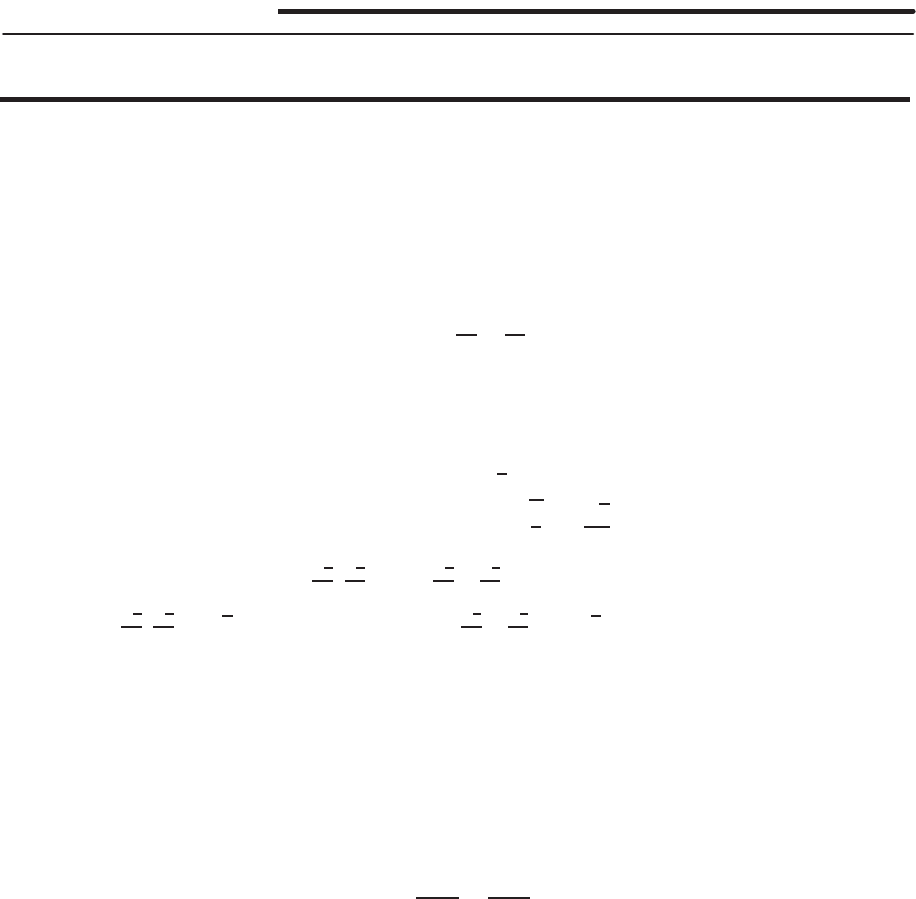
15.3 SOLUTIONS 1413
43. False. On the given region the function fis always less than one. By picking points closer and closer to the circle
x2+y2= 1 we can make flarger and larger (although never larger than one). There is no point in the open disk that
gives fits largest value.
44. False. While fcan only have (at most) one largest value, it may attain this value at more than one point. For example, the
function f(x, y) = sin(x+y)has a global maximum of 1 at both (π/2,0) and (0, π/2).
45. True. The region is both closed and bounded, guaranteeing both a global maximum and minimum.
46. True. The global minimum could occur on the boundary of the region.
Solutions for Section 15.3
Exercises
1. Our objective function is f(x, y) = x+yand our equation of constraint is g(x, y) = x2+y2= 1. To optimize f(x, y)
with Lagrange multipliers, we solve ∇f(x, y) = λ∇g(x, y)subject to g(x, y) = 1. The gradients of fand gare
∇f(x, y) = ~
i+~
j ,
∇g(x, y) = 2x
~
i+ 2y~
j .
So the equation ∇f=λ∇gbecomes
~
i+~
j=λ(2x
~
i+ 2y~
j)
Solving for λgives
λ=1
2x=1
2y,
which tells us that x=y. Going back to our equation of constraint, we use the substitution x=yto solve for y:
g(y, y) = y2+y2= 1
2y2= 1
y2=1
2
y=±r1
2=±√2
2.
Since x=y, our critical points are (√2
2,√2
2)and (−√2
2,−√2
2). Since the constraint is closed and bounded, maximum
and minimum values of fsubject to the constraint exist. Evaluating fat the critical points we find that the maximum
value is f(√2
2,√2
2) = √2and the minimum value is f(−√2
2,−√2
2) = −√2.
2. The Lagrange conditions give:
1 = λ2x, 3 = λ2y.
Thus 2λ= 1/x = 3/y, so y= 3x. Substituting this into the constraint, we get x2+ (3x)2= 10, so x=±1. Since
y= 3x, the points satisfying the Lagrange conditions are (1,3) and (−1,−3). Since f(1,3) = 12 and f(−1,−3) = −8,
the maximum value is 12 at (1,3) and the minimum value is −8at (−1,−3).
3. The Lagrange conditions give:
2(x−1) = λ2x, 2(y+ 2) = λ2y.
We can’t have x= 0, since then the first equation becomes −2 = 0. Similarly, y6= 0. Thus we can divide by xand y.
Solving both equations for λand setting the expressions equal, we get
x−1
x=y+ 2
y.
Thus, we have y(x−1) = x(y+ 2), so y=−2x. Substituting this into the constraint, we get x2+ (−2x)2= 5, so
x=±1. Since y=−2x, the points satisfying the Lagrange conditions are (1,−2) and (−1,2). Since f(1,−2) = 0 and
f(−1,2) = 20, the maximum value is 20 at (−1,2) and the minimum value is 0at (1,−2).
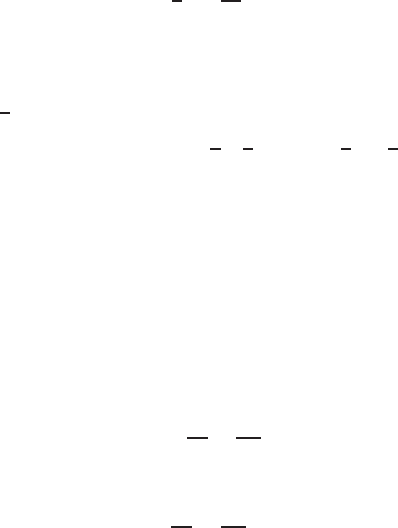
1414 Chapter Fifteen /SOLUTIONS
4. The Lagrange conditions give:
3x2=λ6x, 1 = λ2y.
If x= 0 in the first equation, then from the constraint, y=±2. Thus (0,±2) are two points satisfying the Lagrange
conditions. If x6= 0, we can solve for λfrom both equations and setting the expressions equal, we get
1
2x=1
2y,
so y= 1/x. Substituting this into the constraint, we get 3x2+ (1/x)2= 4. Therefore 3x4+ 1 = 4x2, so
3x4−4x2+ 1 = (x2−1)(3x2−1) = 0.
Therefore x=±1, x =±1/√3. Since y= 1/x, we get
(1,1),(−1,−1),(1/√3,√3),(−1/√3,−√3),
as points satisfying the Lagrange conditions. The corresponding values of f(x, y)are 2,−2,1.92,−1.92. There are also
the points (0,±2) we found for the case x= 0, and the values for fthere are ±2. Thus the maximum value is 2at (1,1)
and (0,2) and the minimum value is −2at (−1,−1) and (0,−2).
5. Our objective function is f(x, y) = 3x−2yand our equation of constraint is g(x, y) = x2+ 2y2= 44. Their gradients
are
∇f(x, y) = 3
~
i−2~
j ,
∇g(x, y) = 2x
~
i+ 4y~
j .
So the equation ∇f=λ∇gbecomes 3
~
i−2~
j=λ(2x
~
i+ 4y~
j). Solving for λgives us
λ=3
2x=−2
4y,
which we can use to find xin terms of y:
3
2x=−2
4y
−4x= 12y
x=−3y.
Using this relation in our equation of constraint, we can solve for y:
x2+ 2y2= 44
(−3y)2+ 2y2= 44
9y2+ 2y2= 44
11y2= 44
y2= 4
y=±2.
Thus, the critical points are (−6,2) and (6,−2). Since the constraint is closed and bounded, maximum and minimum
values of fsubject to the constraint exist. Evaluating fat the critical points, we find that the maximum is f(6,−2) =
18 + 4 = 22 and the minimum value is f(−6,2) = −18 −4 = −22.
6. The objective function is f(x, y) = 2xy and the constraint equation is g(x, y) = 5x+ 4y= 100, so grad f=
(2y)
~
i+ (2x)~
jand grad g= 5
~
i+ 4~
j. Setting grad f=λgrad ggives
2y= 5λ,
2x= 4λ.
From the first equation we have λ= 2y/5, and from the second equation we have λ=x/2. Setting these equal gives
y= 1.25x.
Substituting this into the constraint equation 5x+ 4y= 100 gives x= 10 and y= 12.5. A maximum or minimum value
for fsubject to the constraint can occur only at (10,12.5).

15.3 SOLUTIONS 1415
We have f(10,12.5) = 250. From Figure 15.18, we see that the point (10,12.5) gives a maximum.
10 20
10
20
30
(10,12.5)
100
250
400
x
5x+4y= 100
y
Figure 15.18
7. Let f(x1, x2) = x12+x22and g(x1, x2) = x1+x2. Then grad f=λgrad ggives
2x1=λ
2x2=λ,
so x1+x2= 1 gives
λ
2+λ
2= 1 or λ= 1.
Thus
x1=x2=1
2.
Since f(x1, x2)becomes arbitrarily large as x1, x2→ ∞, there is no global maximum. The global minimum is given by
f1
2,1
2=1
22
+1
22
=1
2.
8. Our objective function is f(x, y) = x2+yand our equation of constraint is g(x, y) = x2−y2= 1. Their gradients are
∇f(x, y) = 2x
~
i+~
j ,
∇g(x, y) = 2x
~
i−2y~
j .
Thus ∇f=λ∇ggives
2x=λ2x
1 = −λ2y
But xcannot be zero, since the constraint equation, −y2= 1, would then have no real solution for y. So the equation
∇f=λ∇gbecomes
λ=2x
2x=1
−2y
1 = 1
−2y
−2y= 1
y=−1
2.
Substituting this into our equation of constraint we find
g(x, −1
2) = x2−−1
22
=1
x2=5
4
x=±√5
2.
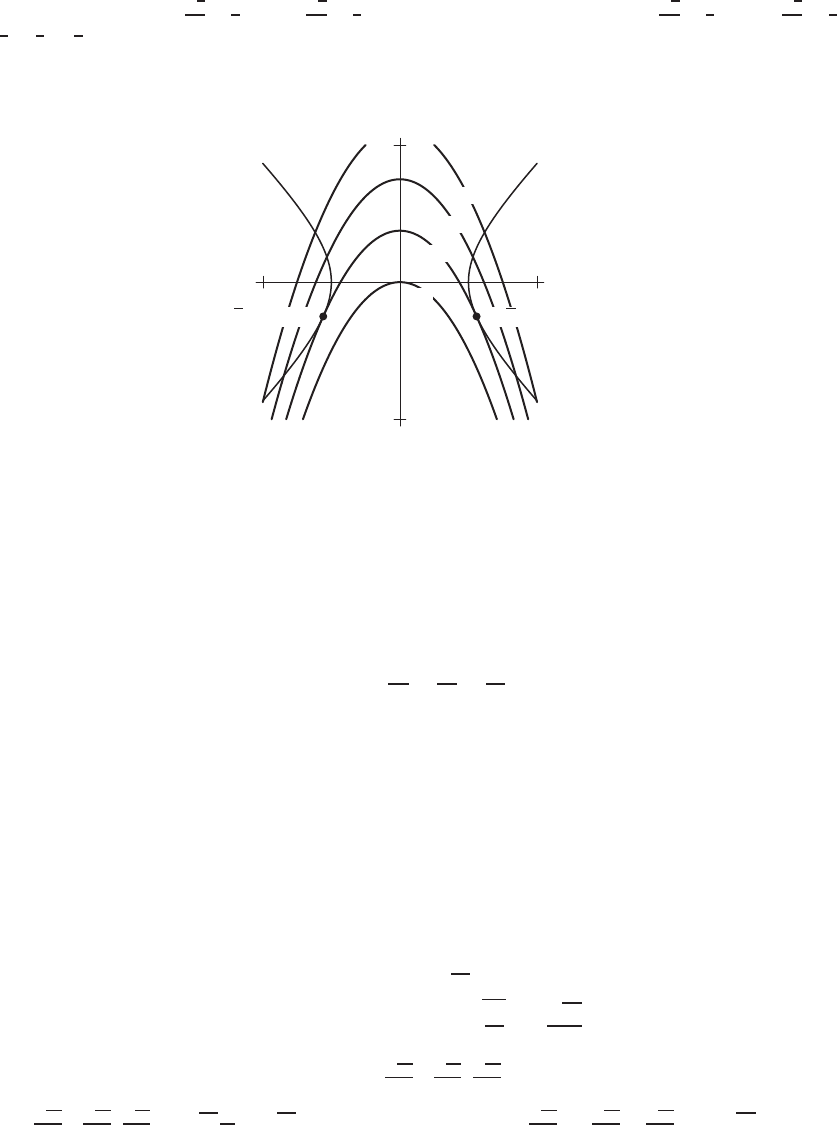
1416 Chapter Fifteen /SOLUTIONS
So the critical points are (√5
2,−1
2)and (−√5
2,−1
2). Evaluating fat these points we find f(√5
2,−1
2) = f(−√5
2,−1
2) =
5
4−1
2=3
4. This is the minimum value for f(x, y)constrained to g(x, y) = 1. To see this, note that for x2=y2+ 1,
f(x, y) = y2+ 1 + y= (y+ 1/2)2+ 3/4≥3/4. Alternatively, see Figure 15.19. To see that fhas no maximum on
g(x, y) = 1, note that f→ ∞ as x→ ∞ and y→ ∞ on the part of the graph of g(x, y) = 1 in quadrant I.
−2 2
−2
2
(√5/2,1/2)(−√5/2,−1/2)
0
0.75
1.5
2.25
x2−y2= 1
x
y
Figure 15.19
: Graph of x2−y2= 1
9. The objective function is f(x, y, z) = x+ 3y+ 5zand the equation of constraint is g(x, y, z) = x2+y2+z2= 1.
Their gradients are
∇f(x, y, z) = ~
i+ 3~
j+ 5~
k ,
∇g(x, y, z) = 2x
~
i+ 2y~
j+ 2z~
k .
So the equation ∇f=λ∇gbecomes~
i+ 3~
j+ 5~
k=λ(2x
~
i+ 2y~
j+ 2z~
k). Solving for λwe find
λ=1
2x=3
2y=5
2z.
Which provides us with the equations
2y= 6x
10x= 2z.
Solving the first equation for ygives us y= 3x. Solving the second equation for zgives us z= 5x. Substituting these
into the equation of constraint, we can find x:
x2+ (3x)2+ (5x)2= 1
x2+ 9x2+ 25x2= 1
35x2= 1
x2=1
35
x=±r1
35 =±√35
35 .
Since y= 3xand z= 5x, the critical points are at ±(√35
35 ,3√35
35 ,√35
7). Since the constraint is closed and bounded, max-
imum and minimum values of fsubject to the constraint exist. Evaluating fat the critical points, we find the maximum
is f(√35
35 ,3√35
35 ,√35
7) = √35 35
35 =√35, and the minimum value is f(−√35
35 ,−3√35
35 ,−√35
7) = −√35.
10. Our objective function is f(x, y, z) = x2−y2−2zand our equation of constraint is g(x, y, z) = x2+y2−z= 0.
To optimize f(x, y, z)with Lagrange multipliers, we solve ∇f(x, y, z) = λ∇g(x, y, z)subject to g(x, y, z) = 0. The
gradients of fand gare
∇f(x, y, z) = 2x
~
i−2y~
j−2~
k ,
∇g(x, y, z) = 2x
~
i+ 2y~
j−~
k .

15.3 SOLUTIONS 1417
We get
2x= 2λx
−2y= 2λy
−2 = −λ
x2+y2=z.
The third equation gives λ= 2 and from the first x= 0, from the second y= 0 and from the fourth z= 0. So the only
solution is (0,0,0), and f(0,0,0) = 0.
To see what kind of extreme point is (0,0,0), let (a, b, c)be a point which satisfies the constraint, i.e. a2+b2=c.
Then f(a, b, c) = a2−b2−2c=−a2−3b2≤0. The conclusion is that 0is the maximum value of fand that there is
no minimum.
11. The Lagrange conditions give:
yz =λ2x, xz =λ2y, xy =λ8z.
We note that if x= 0, then the objective function f(x, y, z) = xyz has value 0and this cannot be the maximum or
minimum value since xyz can take on both positive and negative values. Similarly, we can assume that y6= 0 and z6= 0.
Solving for λand setting expressions equal, we get:
yz
x=xz
y=xy
4z.
Thus y2z=x2zso y2=x2, and 4xz2=xy2, so y2= 4z2. Therefore
x2+y2+ 4z2=y2+y2+y2= 12,
so y=±2. Since x=±yand z=±y/2, there are eight points satisfying the Lagrange conditions, each of the
form (±2,±2,±1). Thus the maximum value of the objective function f(x, y, z) = xyz is 4at (2,2,1),(2,−2,−1),
(−2,2,−1),(−2,−2,1), and the minimum value is −4at (−2,−2,−1),(2,2,−1),(2,−2,1),(−2,2,1).
12. The region x2+y2≤4is the shaded disk of radius 2centered at the origin (including the circle x2+y2= 4) shown in
Figure 15.20.
−4 4
−4
4
14
8
16
x
y
Figure 15.20
We will first find the local maxima and minima in the interior of the disk. So we need to find the extrema of
f(x, y) = x2+ 2y2in the region x2+y2<4.
For this we compute the critical points:
fx= 2x= 0
fy= 4y= 0
So the critical point is (0,0). As fxx(0,0) = 2,fyy (0,0) = 4 and fxy (0,0) = 0 we have
D=fxx(0,0) ·fyy (0,0) −(fxy(0,0))2= 8 >0and fxx(0,0) = 2 >0.
Therefore (0,0) is a minimum point and f(0,0) = 0.
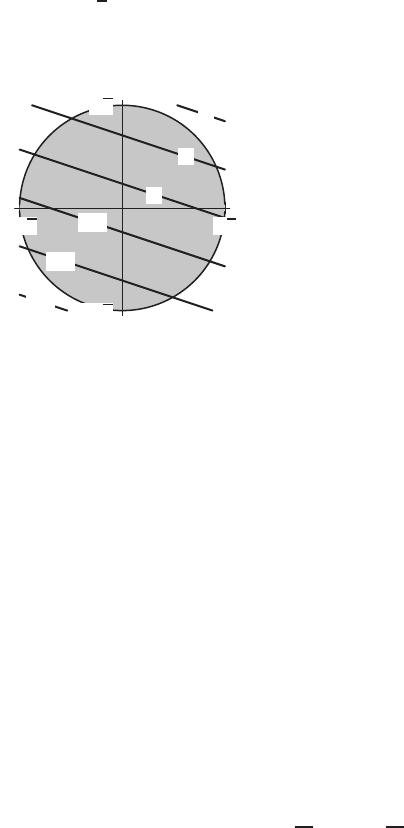
1418 Chapter Fifteen /SOLUTIONS
Now let’s find the local extrema of fon the boundary of the disk, hence this time we have to solve a constraint
problem. We want the extrema of f(x, y) = x2+ 2y2subject to g(x, y) = x2+y2−4 = 0. We use Lagrange
multipliers:
grad f=λgrad gand x2+y2= 4,
which give
2x= 2λx
4y= 2λy
x2+y2= 4.
From the first equation we have x= 0 or λ= 1. If x= 0, from the last equation y2= 4 and therefore (0,2) and
(0,−2) are solutions.
If x6= 0 then λ= 1 and from the second equation y= 0. Substituting this into the third equation we get x2= 4 so
(2,0) and (−2,0) are the other two solutions.
The region x2+y2≤4is closed and bounded, so maximum and minimum values of fin the the region exist.
Therefore, as f(0,2) = f(0,−2) = 8 and f(2,0) = f(−2,0) = 4,(0,2) and (0,−2) are global maxima and (0,0) is
the global minimum on the whole region. The maximum value of fis 8and the minimum value of fis 0.
13. The region x2+y2≤2is the shaded disk of radius √2centered at the origin (including the circle x2+y2= 2) as shown
in Figure 15.21.
−√2√2
−√2
√2
1
3
5
−1
−3
−5
x
y
Figure 15.21
We first find the local maxima and minima of fin the interior of our disk. So we need to find the extrema of
f(x, y) = x+ 3y, in the region x2+y2<2.
As
fx= 1
fy= 3
fdoes not have critical points. Now let’s find the local extrema of fon the boundary of the disk. We want to find the
extrema of f(x, y) = x+ 3ysubject to the constraint g(x, y) = x2+y2−2 = 0. We use Lagrange multipliers
grad f=λgrad gand x2+y2= 2,
which give
1 = 2λx
3 = 2λy
x2+y2= 2.
As λcannot be zero, we solve for xand yin the first two equations and get x=1
2λand y=3
2λ. Plugging into the third
equation gives
8λ2= 10

15.3 SOLUTIONS 1419
so λ=±√5
2and we get the solutions (1
√5,3
√5)and (−1
√5,−3
√5). Evaluating fat these points gives
f(1
√5,3
√5) = 2√5and
f(−1
√5,−3
√5) = −2√5
The region x2+y2≤2is closed and bounded, so maximum and minimum values of fin the region exist. Therefore
(1
√5,3
√5)is a global maximum of fand (−1
√5,−3
√5)is a global minimum of fon the whole region x2+y2≤2.
14. The domain x2+2y2≤1is the shaded interior of the ellipse x2+2y2= 1 including the boundary, shown in Figure 15.22.
−1 1
−1
√2
−1
√2
0.1
0.3
0.5
−0.1
−0.3
−0.5
x
y
Figure 15.22
First we want to find the local maxima and minima of fin the interior of the ellipse. So we need to find the extrema
of
f(x, y) = xy, in the region x2+ 2y2<1.
For this we compute the critical points:
fx=y= 0 and fy=x= 0.
So there is one critical point, (0,0). As fxx(0,0) = 0,fyy (0,0) = 0 and fxy (0,0) = 1 we have
D=fxx(0,0) ·fyy (0,0) −(fxy(0,0))2=−1<0
so (0,0) is a saddle and fdoes not have local extrema in the interior of the ellipse.
Now let’s find the local extrema of fon the boundary, hence this time we’ll have a constraint problem. We want the
extrema of f(x, y) = xy subject to g(x, y) = x2+ 2y2−1 = 0. We use Lagrange multipliers:
grad f=λgrad gand x2+ 2y2= 1
which give
y= 2λx
x= 4λy
x2+ 2y2= 1
From the first two equations we get
xy = 8λ2xy.
So x= 0 or y= 0 or 8λ2= 1.
If x= 0, from the last equation 2y2= 1 so y=±√2
2and we get the solutions (0,√2
2)and (0,−√2
2).
If y= 0, from the last equation we get x2= 1 and so the solutions are (1,0) and (−1,0).
If x6= 0 and y6= 0 then 8λ2= 1, hence λ=±1
2√2. For λ=1
2√2
x=√2y
and plugging into the third equation gives 4y2= 1 so we get the solutions (√2
2,1
2)and (−√2
2,−1
2).
For λ=−1
2√2we get
x=−√2y
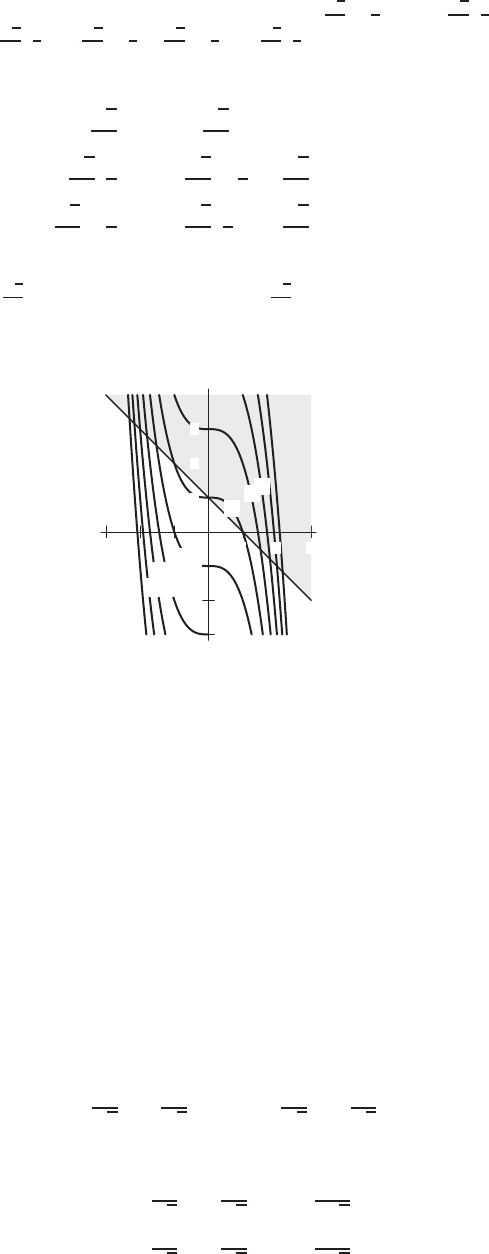
1420 Chapter Fifteen /SOLUTIONS
and plugging into the third equation gives 4y2= 1, and the solutions (√2
2,−1
2)and (−√2
2,1
2). So finally we have the
solutions: (1,0),(−1,0),(√2
2,1
2),(−√2
2,−1
2),(√2
2,−1
2),(−√2
2,1
2).
Evaluating fat these points gives:
f(0,√2
2) = f(0,−√2
2) = f(1,0) = f(−1,0) = 0
f(√2
2,1
2) = f(−√2
2,−1
2) = √2
4
f(√2
2,−1
2) = f(−√2
2,1
2) = −√2
4.
The region x2+ 2y2≤1is closed and bounded, so the maximum and minimum values of fin the region exist. Hence
the maximum value of fis √2
4and the minimum value of fis −√2
4.
15. The region x+y≥1is the shaded half plane (including the line x+y= 1) shown in Figure 15.23.
123
1
2
3
1
35
−1
−3
−5
x
y
Figure 15.23
Let’s look for the critical points of fin the interior of the region. As
fx= 3x2
fy= 1
there are no critical points inside the shaded region. Now let’s find the extrema of fon the boundary of our region. We
want the extrema of f(x, y) = x3+ysubject to the constraint g(x, y) = x+y−1 = 0. We use Lagrange multipliers
grad f=λgrad gand x+y= 1,
which give
3x2=λ
1 = λ
x+y= 1.
From the first two equations we get 3x2= 1, so the solutions are
(1
√3,1−1
√3)and (−1
√3,1 + 1
√3).
Evaluating fat these points we get
f(1
√3,1−1
√3) = 1 −2
3√3
f(−1
√3,1 + 1
√3) = 1 + 2
3√3.
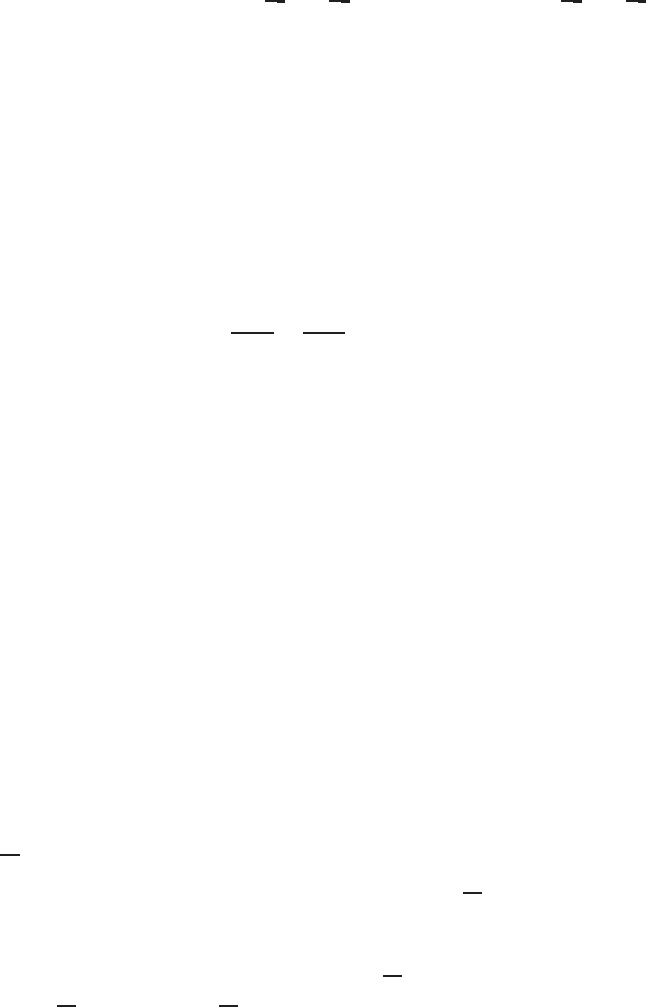
15.3 SOLUTIONS 1421
From the contour diagram in Figure 15.23, we see that (1
√3,1−1
√3)is a local minimum and (−1
√3,1 + 1
√3)is a local
maximum of fon x+y= 1. Are they global extrema as well?
If we take xvery big and y= 1 −xthen f(x, y) = x3+y=x3−x+ 1 which can be made as big as we want (if
we choose xbig enough). So there will be no global maximum.
Similarly, taking xnegative with big absolute value and y= 1 −x,f(x, y) = x3+y=x3−x+ 1 can be made as
small as we want (if we choose xsmall enough). So there is no global minimum. This can also be seen from Figure 15.23.
16. First, we look for critical points for f:
2(x+ 3) = 0,2(y−3) = 0.
Thus the only critical point for fis (−3,3), but this point does not satisfy the constraint x2+y2≤2, so we do not use
it. The Lagrange conditions are
2(x+ 3) = λ2x, 2(y−3) = λ2y.
If x= 0, the first equation becomes 3 = 0, so x6= 0. Similarly, y6= 0. Solving for λand setting expressions equal, we
have x+ 3
x=y−3
y.
Thus, (x+ 3)y= (y−3)x, so y=−x. Substituting this into the constraint equation, we get 2x2= 2, so x=±1. Since
y=−x, the points satisfying the Lagrange conditions are (1,−1) and (−1,1). Since f(1,−1) = 32 and f(−1,1) = 8,
the maximum value is 32 at (1,−1) and the minimum value is 8at (−1,1).
17. We first find the critical points of f:
fx= 2xy = 0, fy=x2+ 6y−1 = 0.
From the first equation, we get either x= 0 or y= 0. If x= 0, from the second equation we get 6y−1 = 0 so y= 1/6.
If instead y= 0, then from the second equation x=±1. We conclude that the critical points are (0,1/6),(1,0), and
(−1,0). All three critical points satisfy the constraint x2+y2≤10.
The Lagrange conditions, grad f=λgrad g, are:
2xy =λ2x, x2+ 6y−1 = λ2y
From the first equation, when x6= 0, we divide by xto get λ=y. Substituting into the second equation, we get
x2+ 6y−1 = 2y2.
Then using x2= 10 −y2from the constraint, we have
10 −y2+ 6y−1 = 2y2,
so 3y2−6y−9 = 0. Factoring, we get 3(y−3)(y+ 1) = 0. From the constraint, we get x=±1when y= 3
and x=±3for y=−1. If instead x= 0, so that we cannot divide by xin the first Lagrange equation, then from the
constraint, y=±√10. Summarizing, the following points are either critical points or satisfy the Lagrange conditions:
(1,0),(−1,0),(0,1/6),(±1,3),(±3,−1),(0,±√10).
These are the candidates for global maximum or minimum points. The corresponding values for f(x, y) = x2y+ 3y2−y
are:
0,0,−1/12,27,−5,30 ∓√10.
The largest value is 30 + √10 at the point (0,−√10) and the smallest value is −5at (±3,−1).
18. (a) Minimum. The minimum value of fon the constraint is f(P) = 20.
(b) Neither. We have f(Q) = 30, which is neither a minimum nor a maximum of fon the constraint because f(P) =
20 < f(Q)< f(R) = 40. The fact that a contour of fand the constraint curve are tangent at Qis not enough to
conclude that f(Q)is either a maximum or minimum of fsubject to the constraint.
(c) Neither. We have f(R) = 40, which is neither a minimum nor a maximum of fon the constraint because f(P) =
20 < f(R)< f(S) = 50.
(d) Maximum. The maximum value of fon the constraint is f(S) = 50.
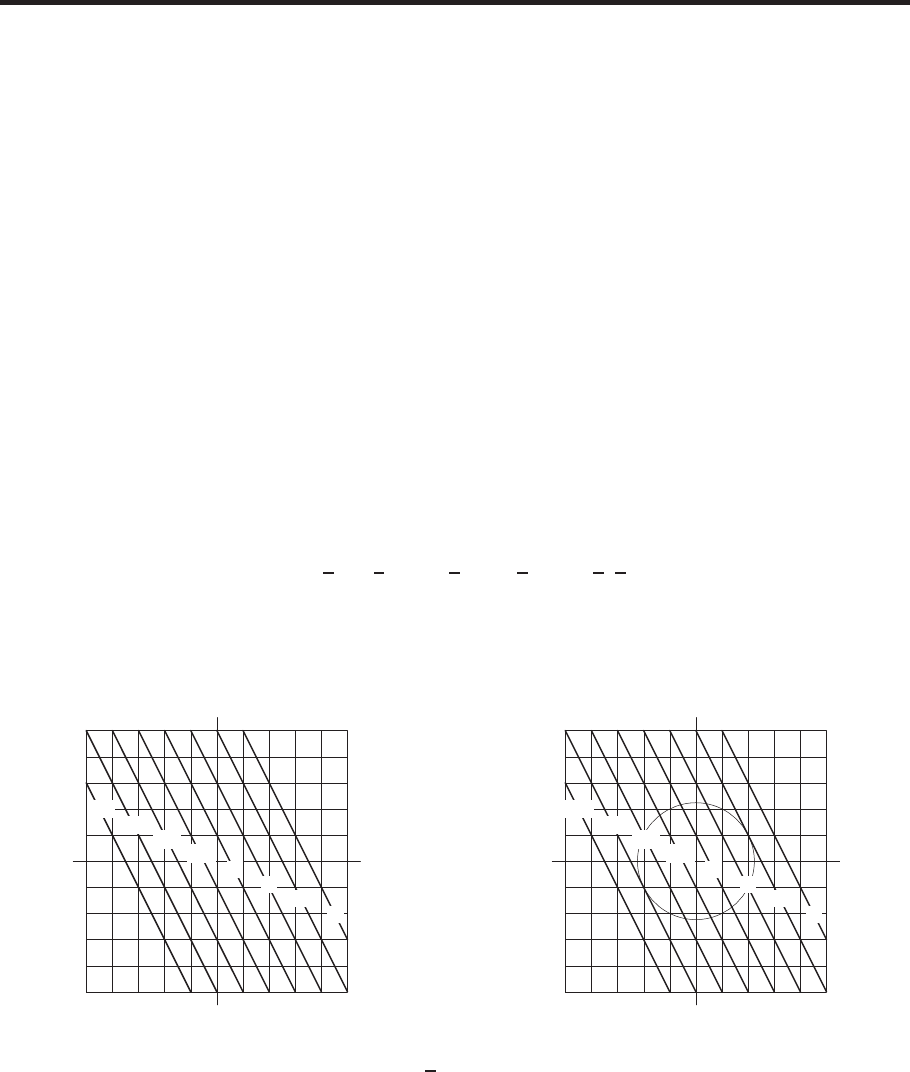
1422 Chapter Fifteen /SOLUTIONS
Problems
19. The function f(x, y) = x+y−(x−y)2attains a maximum value at a critical point inside the triangle or somewhere on
its boundary.
At a critical point we have
fx= 1 −2(x−y) = 0,so 2(x−y) = 1
fy= 1 + 2(x−y) = 0,so 2(x−y) = −1.
The equations have no solution, so fhas no critical points.
We next find the maximum of fon each edge of the triangle separately. Each edge is a constraint and the maximum
on an edge can be found by the method of Lagrange multipliers. It is also very easy to use the equation of an edge to
change the 2-variable constrained maximum problem into a 1-variable maximum problem, which we do for the two edges
lying on the xand y-axes.
On the boundary segment x= 0,0≤y≤1, we have f(0, y) = y−y2which attains a maximum at the point
(0,1/2).
On the boundary segment 0≤x≤1,y= 0, we have f(x, 0) = x−x2which attains a maximum at the point
(1/2,0).
On the boundary segment x+y= 1,0≤x≤1,0≤y≤1, we use the method of Lagrange multipliers with
constraint g(x, y) = x+y= 1. The equations
fx=λgxfy=λgyg= 1
give
1−2(x−y) = λ1 + 2(x−y) = λ x +y= 1
with solution (x, y) = (1/2,1/2). On the edge we have f(x, y) = x+y−(x−y)2= 1 −(x−y)2so we see that
(1/2,1/2) gives a constrained maximum. Since
f0,1
2=1
4f1
2,0=1
4f1
2,1
2= 1
we learn that fattains a maximum value of 1 at the point (x, y) = (1/2,1/2) on the boundary of the triangle.
20. (a) The contour for z= 1 is the line 1 = 2x+y, or y=−2x+ 1. The contour for z= 3 is the line 3 = 2x+y, or
y=−2x+ 3. The contours are all lines with slope −2. See Figure 15.24.
−1−2−3−4−5 12345
−1
−2
−3
−4
−5
1
2
3
4
5
−7
−5
−3
−1
1
3
5
7
x
y
Figure 15.24
−1−2−3−4−5 12345
−1
−2
−3
−4
−5
1
2
3
4
5
−7
−5
−3
−1
1
3
5
7
x
y
Figure 15.25
(b) The graph of x2+y2= 5 is a circle of radius √5 = 2.236 centered at the origin. See Figure 15.25.
(c) The circle representing the constraint equation in Figure 15.25 appears to be tangent to the contour close to z= 5 at
the point (2,1), and this is the contour with the highest z-value that the circle intersects. The circle is tangent to the
contour z=−5approximately at the point (−2,−1), and this is the contour with the lowest z-value that the circle
intersects. Therefore, subject to the constraint x2+y2= 5, the function fhas a maximum value of about 5 at the
point (2,1) and a minimum value of about −5at the point (−2,−1).
Since the radius vector, 2
~
i+~
j, at the point (2,1) is perpendicular to the line 2x+y= 5, the maximum is
exactly 5 and occurs at (2,1). Similarly, the minimum is exactly −5and occurs at (−2,−1).
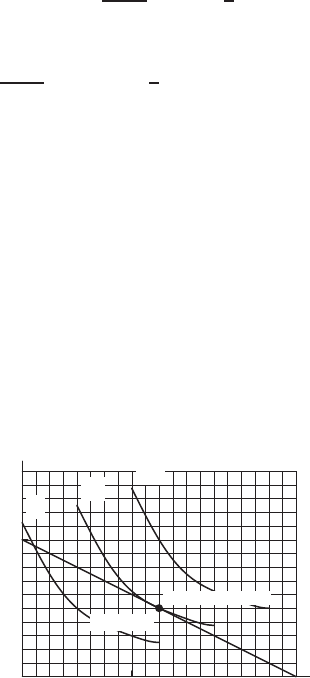
15.3 SOLUTIONS 1423
(d) The objective function is f(x, y) = 2x+yand the constraint equation is g(x, y) = x2+y2= 5, and so grad f=
2
~
i+~
jand grad g= (2x)
~
i+ (2y)~
j. Setting grad f=λgrad ggives
2 = λ(2x),
1 = λ(2y).
On the constraint, x6= 0 and y6= 0. Thus, from the first equation, we have λ= 1/x, and from the second equation
we have λ= 1/(2y). Setting these equal gives
x= 2y.
Substituting this into the constraint equation x2+y2= 5 gives (2y)2+y2= 5 so y=−1and y= 1. Since x= 2y,
the maximum or minimum values occur at (2,1) or (−2,−1). Since f(2,1) = 5 and f(−2,−1) = −5, the function
f(x, y) = 2x+ysubject to the constraint x2+y2= 5 has a maximum value of 5 at the point (2,1) and a minimum
value of −5at the point (−2,−1). This confirms algebraically what we observed graphically in part (c).
21. Let g(x, y) = 2x+ 3y, so the line is g(x, y) = 6. At the maximum on the line grad f=λgrad g, so
fx=αxα−1y1−α=λ·2
fy= (1 −α)xαy−α=λ·3.
Dividing to eliminate λwe have
α
1−αx−1y1=2
3.
Since (1.5,1) is a critical point, we have
α
1−α(1.5)−111=2
3
3α= 2(1.5)(1 −α) = 3(1 −α)
3α= 3 −3α
α= 0.5.
22. We know that a maximum or minimum value of fsubject to the constraint equation g(x, y) = coccurs where grad f
is parallel to grad g, or at the endpoints of the constraint. The vectors grad fand grad gare parallel where the graph of
g(x, y) = cis tangent to the contours of f, which occurs at approximately x= 6 and y= 6. At the point (6,6), we
have f= 400. The graph of g(x, y) = ccrosses the contours f= 300,f= 200,f= 100 but does not cross any
contours with f-values greater than 400. We see that the maximum of fsubject to the constraint is 400 at the point (6,6).
It appears that ftakes on its minimum value (less than 100) at one of the endpoints, which are approximately (10.5,0)
and (0,13.5).
23. (a) The curves are shown in Figure 15.26.
20 40 60 80 100
500
1000
1500
I
II
III
(50,500)
s= 1000 −10l
l
s
Figure 15.26
(b) The income equals $10/hour times the number of hours of work:
s= 10(100 −l) = 1000 −10l.
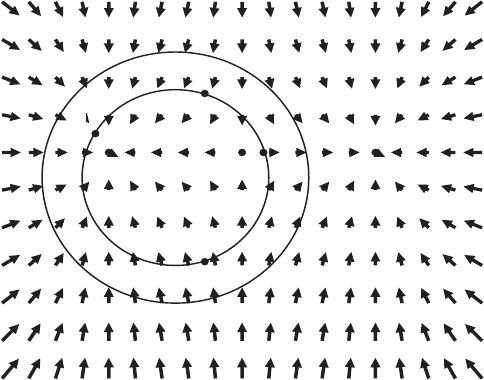
1424 Chapter Fifteen /SOLUTIONS
(c) The graph of this constraint is the straight line in Figure 15.26.
(d) For any given salary, curve III allows for the most leisure time, curve I the least. Similarly, for any amount of leisure
time, curve III also has the greatest salary, and curve I the least. Thus, any point on curve III is preferable to any point
on curve II, which is preferable to any point on curve I. We prefer to be on the outermost curve that our constraint
allows. We want to choose the point on s= 1000 −10lwhich is on the most preferable curve. Since all the curves
are concave up, this occurs at the point where s= 1000 −10lis tangent to curve II. So we choose l= 50,s= 500,
and work 50 hours a week.
24. (a) The gradient vectors, ∇f, point inward around a local maximum. See the two points marked Ain Figure 15.27.
(b) Some of the gradient vectors around a saddle are pointing inward toward the point; some are pointing outward away
from the point. See the point marked Bin Figure 15.27.
(c) The critical points on g= 1 are at points where ∇fis perpendicular to the curve g= 1. There are four of them, all
marked with a dot in Figure 15.27. Imagine the level surfaces of fsketched in everywhere perpendicular to ∇f; the
maximum value of fis at the point marked Cin Figure 15.27
(d) Again imagine level curves of f. The minimum value of fis at the point marked D.
A A
C
B
D
Figure 15.27
(e) At C, the maximum on g= 1, the vector ∇gpoints outward (because it points toward g = 2), while ∇fpoints
inward. The Lagrange multiplier, λ, is defined so that ∇f=λ∇g, so λmust be negative.
25. (a) The point Pgives a minimum; the maximum is at one of the end points of the line segment (either the x- or the
y-intercept). The value of λis negative, since fdecreases in the direction in which gincreases.
(b) The point Pgives a maximum; the minimum is at the x- or y-intercept. The value of λis positive, since fand g
increase in the same direction.
26. Since λis the additional quantity of fthat is obtained by relaxing the constraint by 1 unit, λis larger if the level curves
of fare close together near the optimal point. The answer is I <II <III.
27. The maximum and minimum values change by approximately λ∆c. The Lagrange conditions give:
3 = λ2x, −2 = λ4y.
Solving for λand setting the expressions equal, we get x=−3y. Substituting into the constraint, we get y=±2, so the
points satisfying the Lagrange conditions are (−6,2) and (6,−2). The corresponding values of f(x, y) = 3x−2yare
−22 and 22. From the first equation, we have λ= 3/(2x). Thus the minimum value changes by 3/(−12)∆c=−∆c/4
and the maximum changes by 3/(12)∆c= ∆c/4.
28. The maximum and minimum values change by approximately λ∆c. The Lagrange conditions give:
y=λ8x, x =λ2y.
Solving for λand setting the expressions equal, we get 4x2=y2. Substituting into the constraint, we get x=±1. Since
y=±2x, the points satisfying the Lagrange conditions are (1,2),(−1,2),(1,−2),(−1,−2). Since f(x, y) = xy, we
get a maximum value of 2at (1,2),(−1,−2) and a minimum value of −2at (1,−2),(−1,2). Since λ=y/(8x), the
maximum value changes by (2/8)∆c= ∆c/4and the minimum changes by −(2/8)∆c/) = −∆c/4.
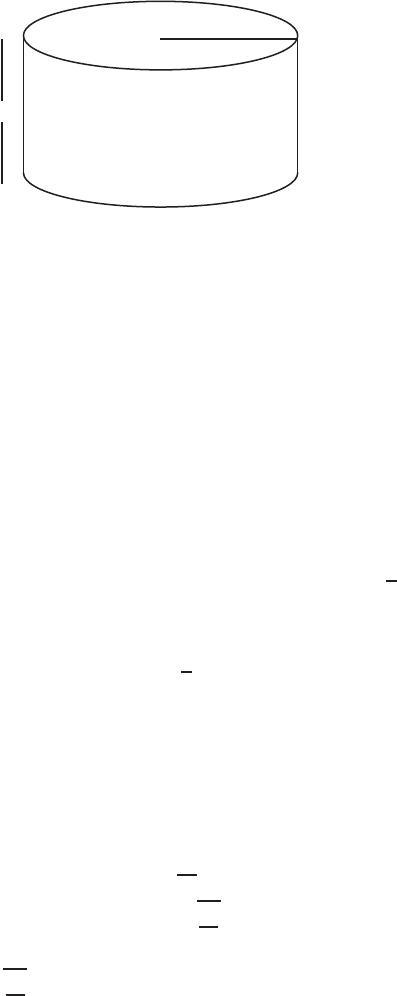
15.3 SOLUTIONS 1425
29. (a) The company wishes to maximize P(x, y)given the constraint C(x, y) = 50,000. The objective function is P(x, y)
and the constraint equation is C(x, y) = 50,000. The Lagrange multiplier λis approximately equal to the change in
P(x, y)given a one unit increase in the budget constraint. In other words, if we increase the budget by $1, we can
produce about λmore units of the good.
(b) The company wishes to minimize C(x, y)given the constraint equation P(x, y) = 2000. The objective function is
C(x, y)and the constraint equation is P(x, y) = 2000. The Lagrange multiplier λis approximately equal to the
change in C(x, y)given a one unit increase in the production constraint. In other words, it costs about λdollars to
produce one more unit of the good.
30.
r
✻
❄
h
✲
Figure 15.28
Let Vbe the volume and Sbe the surface area of the container. Then
V=πr2hand S= 2πrh + 2πr2
where his the height and ris the radius as shown in Figure 15.28. We have V= 100 cm3as our constraint. Since
∇S= (2πh + 4πr)
~
i+ 2πr~
j=π((2h+ 4r)
~
i+ 2r~
j)
and ∇V= 2πrh
~
i+πr2~
j=π(2rh
~
i+r2~
j),
at the optimum
∇S=λ∇V, we have
π((2h+ 4r)
~
i+ 2r~
j) = πλ(2rh
~
i+r2~
j),
that is 2h+ 4r= 2λrh and 2r=λr2,hence λ=2
r.
We assume r6= 0 or else we have a very awkward cylinder. Then, plug λ= 2/r into the first equation to obtain:
2h+ 4r= 2 2
rrh
2h+ 4r= 4h
h= 2r.
Finally, solve for rand husing the constraint:
V=πr2h= 100
πr2(2r) = 100
r3=50
π
r=3
r50
π.
Solving for h, we obtain h= 2r= 2 3
r50
π.
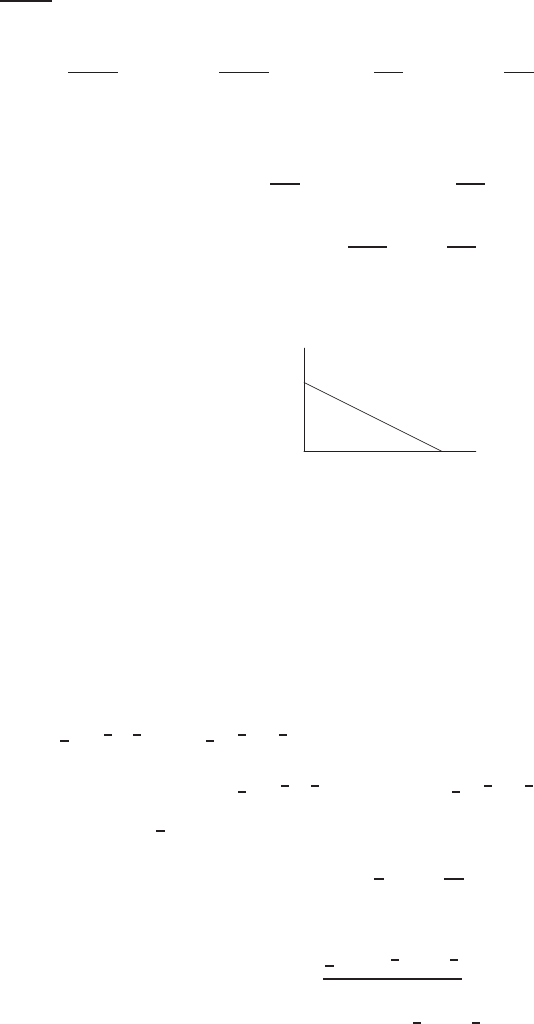
1426 Chapter Fifteen /SOLUTIONS
31. (a) We want to minimize Csubject to g=x+y= 39. Solving ∇C=λ∇ggives
10x+ 2y=λ
2x+ 6y=λ
so y= 2x. Solving with x+y= 39 gives x= 13, y = 26, λ = 182. Therefore C= $4349.
(b) Since λ= 182, increasing production by 1will cause costs to increase by approximately $182. (because λ=
k∇Ck
k∇gk=rate of change of Cwith g). Similarly, decreasing production by 1will save approximately $182.
32. Using Lagrange multipliers, let G= 2000 −5x−10y= 0 be the constraint.
∇P=1 + 2xy2
2·108~
i+2 + 2yx2
2·108~
j=1 + xy2
108~
i+2 + yx2
108~
j .
∇G=−5
~
i−10~
j .
Now, ∇P=λ∇G, so
1 + xy2
108=−5λand 2 + yx2
108=−10λ.
Thus
2 + 2xy2
108= 2 + yx2
108.
Solving, we get 2y=xor x= 0 or y= 0.
400
200
x
y
Constraint
G= 0
Figure 15.29
From G= 0 we have: when x= 0, y = 200, when y= 0, x = 400, and when x= 2y, x = 200, y = 100. So
(0,200), (400,0) and (200,100) are the critical points and they include the end points.
Substitute into P:P(0,200) = 400, P (400,0) = 400, P (200,100) = 402 so the organization should buy 200 sacks of
rice and 100 sacks of beans.
33. (a) Let cbe the cost of producing the product. Then c= 10W+ 20K= 3000.At optimum production,
∇q=λ∇c.
∇q=9
2W−1
4K1
4~
i+3
2W3
4K−3
4~
j, and ∇c= 10
~
i+ 20~
j . Equating we get
9
2W−1
4K1
4=λ10,and 3
2W3
4K−3
4=λ20.
Dividing yields K=1
6W, so substituting into cgives
10W+ 20 1
6W=40
3W= 3000.
Thus W= 225 and K= 37.5. Substituting both answers to find λgives
λ=
9
2(225)−1
4(37.5) 1
4
10 = 0.2875.
We also find the optimum quantity produced, q= 6(225) 3
4(37.5) 1
4= 862.57.
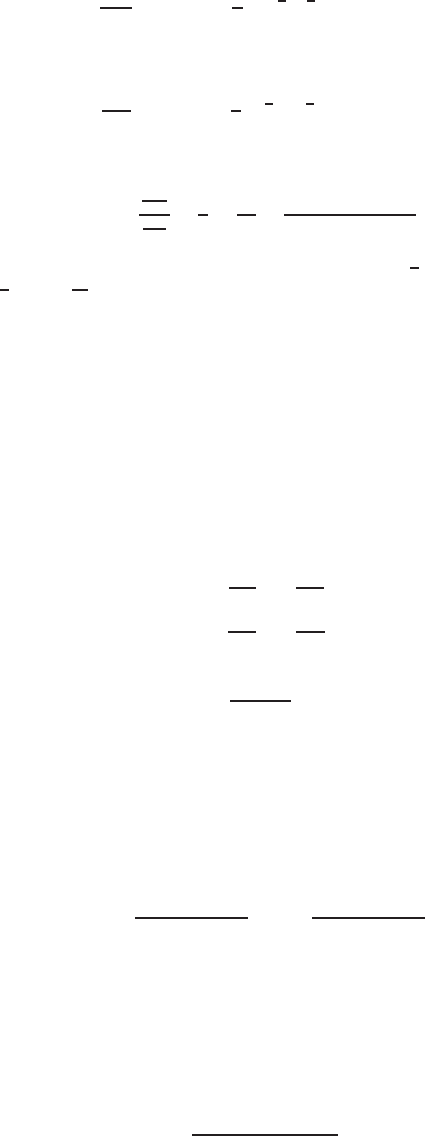
15.3 SOLUTIONS 1427
(b) At the optimum values found above, marginal productivity of labor is given by
∂q
∂W (225,37.5)
=9
2W−1
4K1
4(225,37.5)
= 2.875,
and marginal productivity of capital is given by
∂q
∂K (225,37.5)
=3
2W3
4K−3
4(225,37.5)
= 5.750.
The ratio of marginal productivity of labor to that of capital is
∂q
∂W
∂q
∂K
=1
2=10
20 =cost of a unit of L
cost of a unit of K.
(c) When the budget is increased by one dollar, we substitute the relation K1=1
6W1into 10W1+ 20K1= 3001 which
gives 10W1+ 20( 1
6W1) = 40
3W1= 3001.Solving yields W1= 225.075 and K1= 37.513,so q1= 862.86 =
q+ 0.29. Thus production has increased by 0.29 ≈λ, the Lagrange multiplier.
34. (a) The problem is to maximize
V= 1000D0.6N0.3
subject to the budget constraint in dollars
40000D+ 10000N≤600000
or (in thousand dollars)
40D+ 10N≤600
(b) Let B= 40D+ 10N= 600 (thousand dollars) be the budget constraint. At the optimum
∇V=λ∇B,
so ∂V
∂D =λ∂B
∂D = 40λ
∂V
∂N =λ∂B
∂N = 10λ.
Thus ∂V /∂D
∂V/∂N = 4.
Therefore, at the optimum point, the rate of increase in the number of visits with respect to an increase in the number
of doctors is four times the corresponding rate for nurses. This factor of four is the same as the ratio of the salaries.
(c) Differentiating and setting ∇V=λ∇Byields
600D−0.4N0.3= 40λ
300D0.6N−0.7= 10λ
Thus, we get
600D−0.4N0.3
40 =λ=300D0.6N−0.7
10
So
N= 2D.
To solve for Dand N, substitute in the budget constraint:
600 −40D−10N= 0
600 −40D−10 ·(2D) = 0
So D= 10 and N= 20.
λ=600(10−0.4)(200.3)
40 ≈14.67
Thus the clinic should hire 10 doctors and 20 nurses. With that staff, the clinic can provide
V= 1000(100.6)(200.3)≈9,779 visits per year.

1428 Chapter Fifteen /SOLUTIONS
(d) From part c), the Lagrange multiplier is λ= 14.67. At the optimum, the Lagrange multiplier tells us that about 14.67
extra visits can be generated through an increase of $1,000 in the budget. (If we had written out the constraint in
dollars instead of thousands of dollars, the Lagrange multiplier would tell us the number of extra visits per dollar.)
(e) The marginal cost, MC, is the cost of an additional visit. Thus, at the optimum point, we need the reciprocal of the
Lagrange multiplier:
MC =1
λ≈1
14.67 ≈0.068 (thousand dollars),
that is, at the optimum point, an extra visit costs the clinic 0.068 thousand dollars, or $68.
This production function exhibits declining returns to scale (e.g. doubling both inputs less than doubles output,
because the two exponents add up to less than one). This means that for large V, increasing Vwill require increasing
Dand Nby more than when Vis small. Thus the cost of an additional visit is greater for large Vthan for small. In
other words, the marginal cost will rise with the number of visits.
35. (a) The solution to Problem 33 gives λ= 0.29. We recalculate λwith a budget of $4000.
The condition that grad q=λgrad(budget)in Problem 33 gives
9
2W−1/4K1/4=λ(10) and 3
2W3/4K−3/4=λ(20),
so K=1
6W. Substituting into the budget constraint after replacing the budget of $3000 by $4000 gives
10W+ 20( 1
6W) = 40
3W= 4000.
Thus, W= 300 and K= 50 and q= 1150.098.
Multiplying the first equation by Wand the second by Kand adding gives
W(9
2W−1/4K1/4) + K(3
2W3/4K−3/4) = W(10λ) + K(20λ).
So
9
2+3
2W3/4K1/4=λ(10W+ 20K)
6W3/4K1/4=λ(4000)
Thus,
λ=6W3/4K1/4
4000 =1150.098
4000 = 0.29
Thus, the value of λremains unchanged.
(b) The solution to Problem 34 shows that λ= 14.67. We solve the problem again with a budget of $700,000.
The condition that grad V=λgrad Bin Problem 34 gives
600D−0.4N0.3= 40λ
300D0.6N−0.7= 10λ
Thus, N= 2D. Substituting in the budget constraint after replacing the budget of 600 by 700 (the budget in measured
in thousands of dollars) gives
40D+ 10(2D) = 700
so D= 11.667 and N= 23.337 and V= 11234.705. As in part a), we multiply the first equation by Dand the
second by Nand add:
D(600D−0.4N0.3) + N(300D0.6N−0.7) = D(40λ) + N(10λ),
so
(600 + 300)D0.6N0.3=λ(400 + 10N)
900D0.6N0.3=λ(700)
Since V= 1000D0.6N0.3= 11234.705, we have
λ=900D0.6N0.3
700 =9
7(V
1000 ) = 14.44.
Thus, the value of λhas changed with the budget.
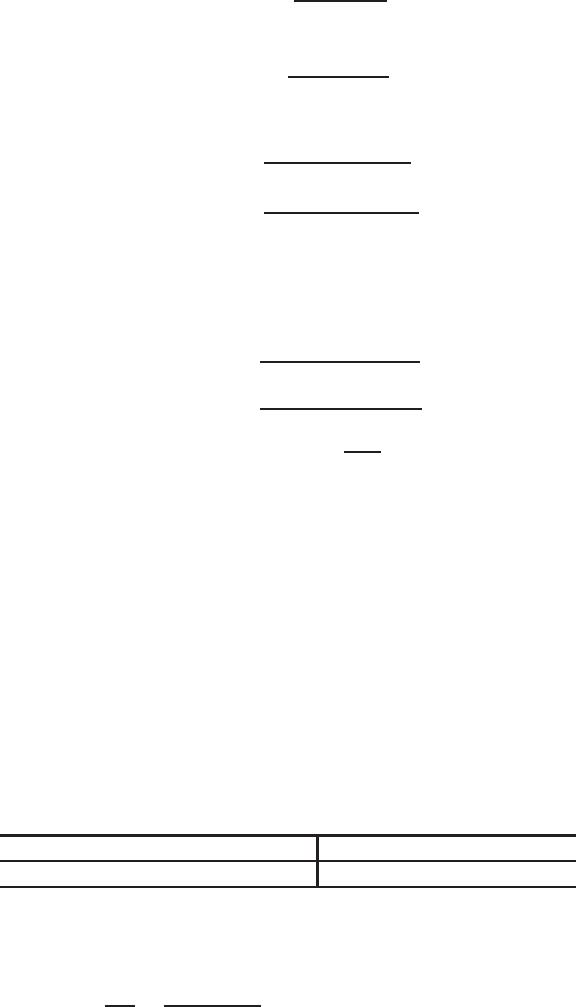
15.3 SOLUTIONS 1429
(c) We are interested in the marginal increase of production with budget (that is, the value of λ) and whether it is affected
by the budget.
Suppose $Bis the budget. In part (a) we found
λ=6W3/4K1/4
B
and in part (b) we found
λ=900D0.6N0.3
B.
In part (a), both Wand Kare proportional to B. Thus, W=c1Band K=c2B, so
λ=6(c1B)3/4(c2B)1/4
B
=6c3/4
1C1/4
2B3/4B1/4
B
= 6c3/4
1c1/4
2.
So we see λis independent of B.
In part (b), both Dand Nare proportional to B, so D=c3Band N=c4B. Thus,
λ=900(c3B)0.6(c4B)0.3
B
=900c0.6
3C0.3
4B0.6B0.3
B
= 900c0.6
3c0.3
4
1
B0.1.
So we see λis not independent of B.
The crucial difference is that the exponents in Problem 33 add to 1, that is 3/4+1/4 = 1, whereas the exponents
in Problem 34 do not add to 1, since 0.6 + 0.3 = 0.9.
Thus, the condition that must be satisfied by the Cobb-Douglas production function
Q=cKaLb
to ensure that the value of λis not affected by production is that
a+b= 1.
This is called constant returns to scale.
36. (a) For a given budget, maximum production is achieved at the point on the budget line that is tangent to a production
contour. Approximate points are shown in Figure 15.30
(b) Estimating production quantities from the contours gives the following values, or close to them:
Budget, B(in dollars) 2000 4000 6000 8000 10000
Max production, M(in pairs of skis per week) 17 33 50 67 83
(c) We estimate the derivative dM/dB at B= $6000 with a difference quotient. Taking values from the table for
B= 6000 and B= 8000 we have
λ=dM
dB ≈67 −50
8000 −6000 = 0.0085 pairs of skis per week per dollar.
For example, increasing the budget from $6000 to $7000 would increase maximum production by approximately
0.0085(1000) = 8.5pairs of skis per week.

1430 Chapter Fifteen /SOLUTIONS
5 10 15 20
5
10
15
20
20
30
40
50
60
70
80
P= 90
2000
4000
6000
B= 8000
10,000
K
, capital
L
, labor
Figure 15.30
37. Since patient 1 has a visit every x1weeks, this patient has 1/x1visits per week. Similarly, patient 2 has 1/x2visits per
week. Thus, the constraint is
g(x1, x2) = 1
x1
+1
x2
=m
To minimize
f(x1, x2) = v1
v1+v2·x1
2+v2
v1+v2·x2
2
subject to g(x1, x2), we solve the equations
grad f=λgrad g
g(x1, x2) = m.
This gives us the equations
∂f
∂x1
=v1
v1+v2·1
2=λ−1
x2
1=λ∂g
∂x1
∂f
∂x2
=v2
v1+v2·1
2=λ−1
x2
2=λ∂g
∂x2
1
x1
+1
x2
=m.
Dividing the first equation by the second gives
v1
v2
=x2
2
x2
1
.
As v1, v2, x1, x2, m are strictly positive we have
x2
x1
=v1
v21
2.
Substituting for x2in the constraint occasion gives
1
x1
+v2
v11
2·1
x1
=m
solving for x1gives
1
x11 + ( v1
v2
)1
2=m
x1=(v1)1
2+ (v2)1
2
m·(v1)1
2
,
and similarly
x2=(v1)1
2+ (v2)1
2
m·(v2)1
2
.
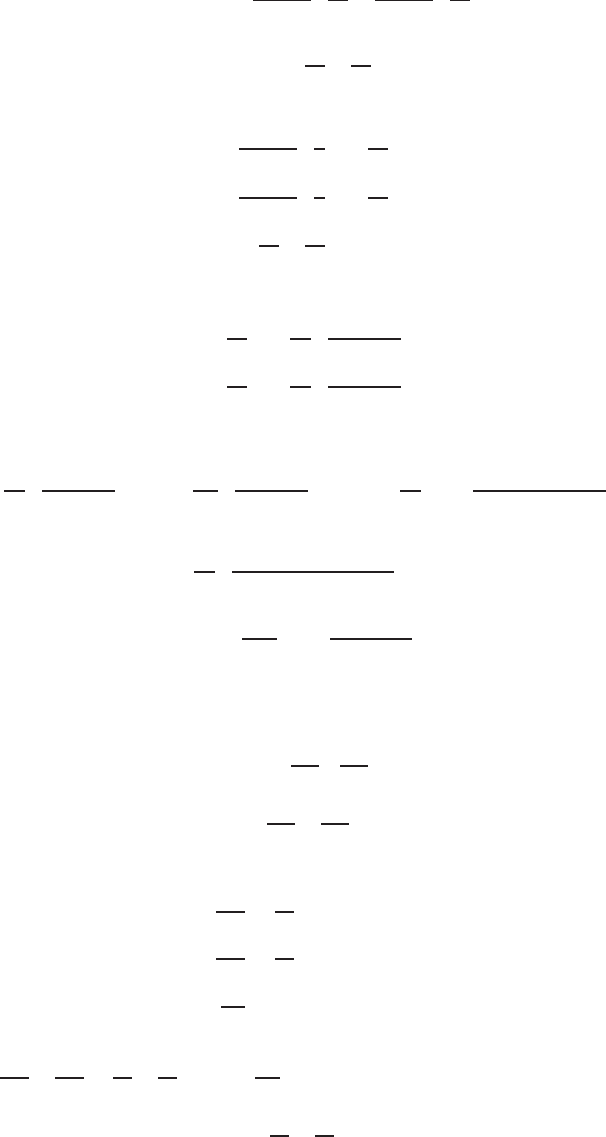
15.3 SOLUTIONS 1431
38. We want to optimize
f(x1, x2) = v1
v1+v2·x1
2+v2
v1+v2·x2
2
subject to
g(x1, x2) = 1
x1
+1
x2
=m.
At the optimum point, x1,x2, and the Lagrange multiplier λmust satisfy the equations
v1
v1+v2·1
2=−λ
x2
1
v2
v1+v2·1
2=−λ
x2
2
1
x1
+1
x2
=m.
Solving the first and second equations for 1/x1and 1/x2, respectively, gives
1
x2
1
=−1
2λ·v1
(v1+v2)
1
x2
2
=−1
2λ·v2
(v1+v2)
substituting into the constraint gives (note that λ < 0):
−1
2λ·v1
(v1+v2)1/2
+−1
2λ·v2
(v1+v2)1/2
=−1
2λ1/2
·(v1)1/2+ (v2)1/2
(v1+v2)1/2=m.
So
−1
2λ·v1+v2+ 2(v1v2)1/2
v1+v2
=m2.
and thus
λ=−1
2m21 + 2(v1v2)1/2
v1+v2.
The units of λare weeks2(since the units of mare 1/weeks). The Lagrange multiplier measures df/dm, which
represents the rate of change in the expected delay in tumor detection as the available number of visits per week increases.
The negative sign represents the fact that as the number of visits per week increases, the delay decreases.
39. (a) The objective function is the complementary energy, f2
1
2k1
+f2
2
2k2
, and the constraint is f1+f2=mg. The Lagrangian
function is
L(f1, f2, λ) = f2
1
2k1
+f2
2
2k2−λ(f1+f2−mg).
We look for solutions to the system of equations we get from grad L=~
0:
∂L
∂f1
=f1
k1−λ= 0
∂L
∂f2
=f2
k2−λ= 0
∂L
∂λ =−(f1+f2−mg) = 0.
Combining ∂L
∂f1−∂L
∂f2
=f1
k1−f2
k2
= 0 with ∂L
∂λ = 0 gives the two equation system
f1
k1−f2
k2
= 0
f1+f2=mg.
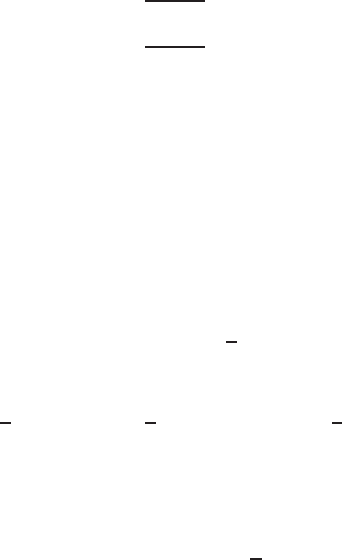
1432 Chapter Fifteen /SOLUTIONS
Substituting f2=mg −f1into the first equation leads to
f1=k1
k1+k2
mg
f2=k2
k1+k2
mg.
(b) Hooke’s Law states that for a spring
Force of spring =Spring constant ·Distance stretched or compressed from equilibrium.
Since f1=k1·λand f2=k2·λ, the Lagrange multiplier λequals the distance the mass stretches the top spring
and compresses the lower spring.
40. (a) Let f(x1, x2, x3) = P3
i=1xi2=x12+x22+x32and g(x1, x2, x3) = P3
i=1 xi= 1. Then grad f=λgrad g
gives
2x1=λand 2x2=λand 2x3=λ.
so
x1=x2=x3=λ
2.
Then x1+x2+x3= 1 gives
3λ
2= 1 so λ=2
3so x1=x2=x3=1
3.
These values of x1, x2, x3give the minimum (rather than maximum) because the value of fincreases without bound
as x2, x2, x3→ ∞.
(b) A similar argument shows that Pn
i=1 xihas its minimum value subject to Pn
i=1 xi= 1 when
x1=x2=···=xn=1
n.
41. The maximum of f(x, y) = ax2+bxy +cy2subject to the constraint g(x, y) = 1 where g(x, y) = x2+y2occurs
where grad f=λgrad g. Since grad f= (2ax +by)
~
i+ (bx + 2cy)~
jand grad g= 2x
~
i+ 2y~
jwe have
2ax +by = 2xλ
bx + 2cy = 2yλ
x2+y2= 1
Adding xtimes the first equation to ytimes the second gives x(2ax +by) + y(bx + 2cy) = (2x2+ 2y2)λ. Dividing by
2 and using the constraint equation gives f(x, y) = ax2+bxy +cy2= (x2+y2)λ=λ. This equation holds for all
solutions (x, y, λ)of the three equations, including the solution that corresponds to the maximum value of fsubject to
the constraint. Thus the maximum value is f(x, y) = λ.
42. Let (x, y, z)be a point on the paraboloid. The square of the distance from (x, y, z)to the point (1,2,10) is given by
f(x, y, z) = (x−1)2+ (y−2)2+ (z−10)2,
and so we wish to minimize f(x, y, z)subject to the constraint
g(x, y, z) = x2+y2−z= 0.
We look for solutions to the equations grad f=λgrad gand g= 0:
2(x−1) = 2λx,
2(y−2) = 2λy,
2(z−10) = −λ,
x2+y2−z= 0.
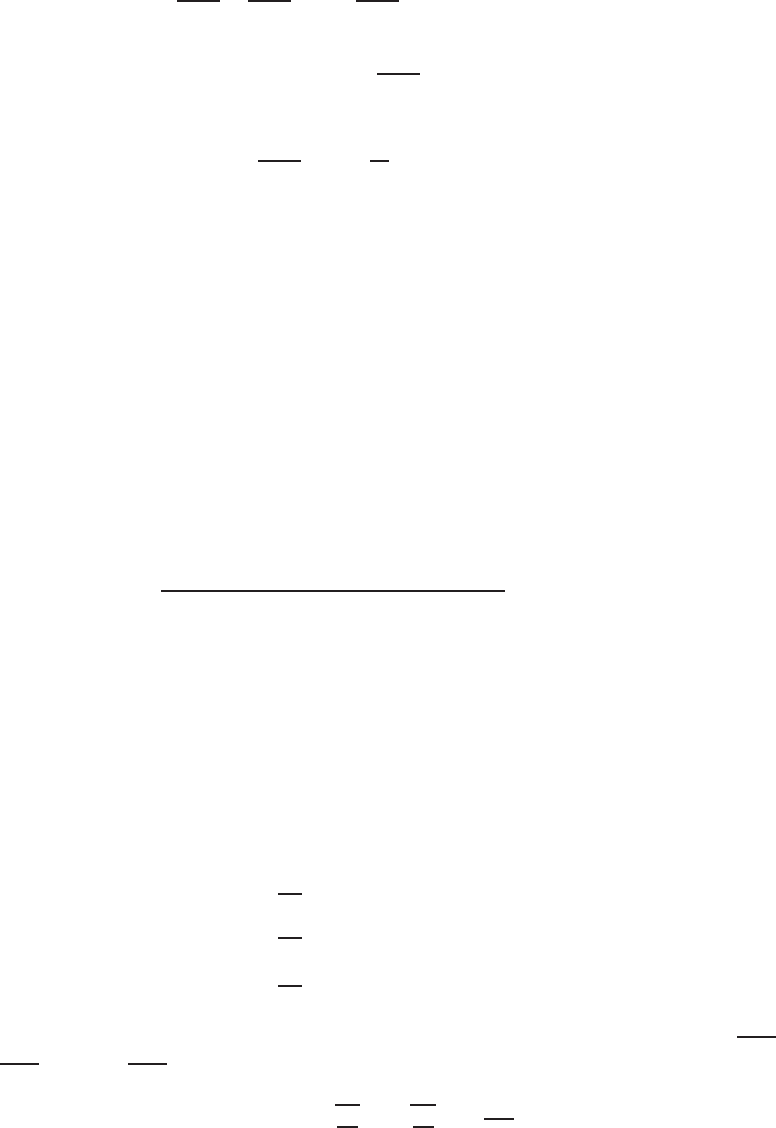
15.3 SOLUTIONS 1433
If λ= 0, the first three equations would imply that (x, y, z) = (1,2,10), which does not satisfy the fourth equation and
so λ6= 0. The first equation then implies that x6= 0 and the second equation implies that y6= 0, so we can eliminate λ
from the first three equations to get:
x−1
x=y−2
yand y−2
y=−2(z−10).
These give
y= 2xand z=2−y
2y+ 10.
Substituting for xand zin the equation z=x2+y2, we obtain
2−y
2y+ 10 = y2
4+y2,
which simplifies to give
5y3−38y−4 = 0.
Let h(y) = 5y3−38y−4. We find that h(−3) <0and h(−1) >0, and so the cubic h(y)has a root between −3
and −1. Similarly, since h(−1) >0and h(0) <0, then h(y)has one a between −1and 0. Finally, as h(0) <0and
h(3) >0, we see that h(y)has a root between 0and 3. Let’s find the root lying between 0and 3. Using a calculator, we
find that this root is approximately given by
y1≈2.808,
and so, using y= 2x, the corresponding point (x, y, z)on the paraboloid z=x2+y2is given by
(x1, y1, z1)≈(1.404,2.808,9.856).
The remaining roots of h(y)are given by y2≈ −0.1055 and y3≈ −2.7026. The corresponding points on the paraboloid
z=x2+y2which satisfy y= 2xare then
(x3, y3, z3)≈(−1.3513,−2.7026,9.1301),
(x2, y2, z2)≈(−0.0528,−0.1055,0.0139),
and so we easily see that the point (1.404,2.808,9.856) will be closest to (1,2,10). Therefore, the minimum distance is
d=p(1.404 −1)2+ (2.808 −2)2+ (9.856 −10)2≈0.9148.
43. (a) The objective function f(x, y) = px +qy gives the cost to buy xunits of input 1 at unit price pand yunits of input
2 at unit price q.
The constraint g(x, y) = utells us that we are only considering the cost of inputs xand ythat can be used to
produce quantity uof the product.
Thus the number C(p, q, u)gives the minimum cost to the company of producing quantity uif the inputs it
needs have unit prices pand q.
(b) The Lagrangian function is
L(x, y, λ) = px +qy −λ(xy −u).
We look for solutions to the system of equations we get from grad L=~
0:
∂L
∂x =p−λy = 0
∂L
∂y =q−λx = 0
∂L
∂λ =−(xy −u) = 0.
We see that λ=p/y =q/x so y=px/q. Substituting for yin the constraint xy =uleads to x=pqu/p,
y=ppu/q and λ=ppq/u. The minimum cost is thus
C(p, q, u) = prqu
p+qrpu
q= 2√pqu.
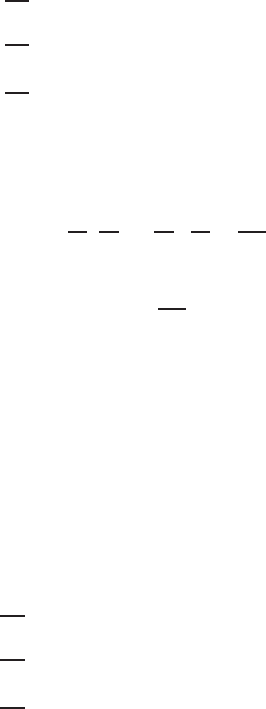
1434 Chapter Fifteen /SOLUTIONS
44. (a) The objective function U(x, y)gives the utility to the consumer of xunits of item 1 and yunits of item 2.
Since px +qy gives the cost to buy xunits of item 1 at unit price pand yunits of item 2 at unit price q, the
constraint px +qy =Itells us that we are only considering the utility of inputs xand ythat can be purchased with
budget I.
Thus the number V(p, q, I)gives the maximum utility the consumer can get with a budget of Iif the two items
have unit prices pand q.
The indirect utility function tells how much utility the consumer can buy, depending on his budget and the prices
of the two items.
(b) The value of the Lagrange multiplier λis the rate of change of the maximum utility Vthe consumer can get with
his budget as the budget increases. This means that for small changes ∆Iin the budget, smart buying will result in a
change ∆V≈λ∆Iin the utility to the consumer of his purchases.
(c) The Lagrangian function is
L(x, y, λ) = xy −λ(px +qy −I).
We look for solutions to the system of equations we get from grad L=~
0:
∂L
∂x =y−λp = 0
∂L
∂y =x−λq = 0
∂L
∂λ =−(px +qy −I) = 0.
We see that λ=y/p =x/q so y=px/q. Substituting for yin the constraint px +qy =Ileads to x=I/(2p),
y=I/(2q)and λ=I/(2pq). The maximum utility is thus
V(p, q, I) = U(I
2p,I
2q) = I
2p·I
2q=I2
4pq .
The marginal utility of money is
λ(p, q, I) = λ=I
2pq .
45. (a) The critical points of h(x, y)occur where
hx(x, y) = 2x−2λ= 0
hy(x, y) = 2y−4λ= 0.
The only critical point is (x, y) = (λ, 2λ)and it gives a minimum value for h(x, y). That minimum value is m(λ) =
h(λ, 2λ) = λ2+ (2λ)2−λ(2λ+ 4(2λ)−15) = −5λ2+ 15λ.
(b) The maximum value of m(λ) = −5λ2+ 15λoccurs at a critical point, where m′(λ) = −10λ+ 15 = 0. At this
point, λ= 1.5and m(λ) = −5·1.52+ 15 ·1.5 = 11.25.
(c) We want to minimize f(x, y) = x2+y2subject to the constraint g(x, y) = 15, where g(x, y) = 2x+ 4y. The
Lagrangian function is L(x, y, λ) = x2+y2−λ(2x+ 4y−15) so we solve the system of equations
∂L
∂x = 2x−2λ= 0
∂L
∂y = 2y−4λ= 0
∂L
∂λ =−(2x+ 4y−15) = 0.
The first two equations give x=λand y= 2λ. Substitution into the third equation gives 2λ+ 4(2λ)−15 = 0
or λ= 1.5. Thus x= 1.5and y= 3. The minimum value of f(x, y)subject to the constraint is f(1.5,3) =
1.53+ 32= 11.25.
(d) The two question have the same answer.
46. (a) By the method of Lagrange multipliers, the point (2,1) is a candidate when the gradient for fat (2,1) is a multiple of
the gradient of the constraint function at (2,1). The constraint function is g(x, y) = x2+y2, so grad g= 2x
~
i+2y~
j.
We have grad g(2,1) = 4
~
i+ 2~
j. This is not a multiple of grad f(2,1) = −3
~
i+ 4~
j, so (2,1) is not a candidate.
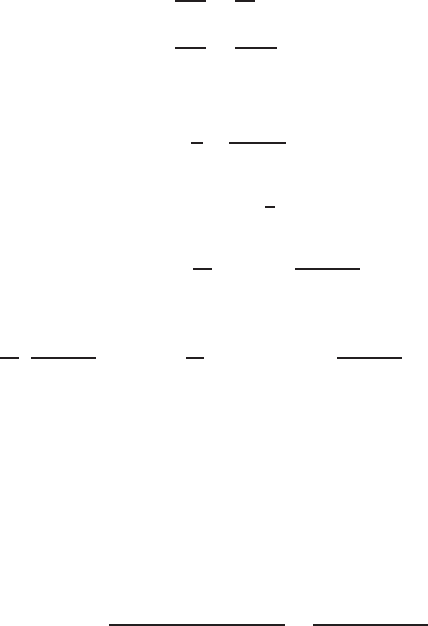
15.3 SOLUTIONS 1435
(b) The constraint function is g(x, y) = (x−5)2+(y+3)2, so grad g= 2(x−5)
~
i+2(y+3)~
j. We have grad g(2,1) =
−6
~
i+ 8~
j. This is a multiple of grad f(2,1) = −3
~
i+ 4~
j, so (2,1) is a candidate.
The contours near (2,1) are parallel straight lines with increasing f-values as we move in the direction of
−3
~
i+ 4~
j(approximately toward the northwest). The center of the constraint circle is at (5,−3), approximately
southeast of the point (2,1). Thus the point (2,1) is a candidate for a maximum.
In general, if the constraint is a circle and grad fpoints outside the circle, then the point is a candidate for a
maximum.
(c) The constraint function is g(x, y) = (x+ 1)2+ (y−5)2. Thus grad g(2,1) = 6
~
i−8~
j, which is again a multiple
of grad f, so (2,1) is a candidate.
This time the center of the constraint circle, (−1,5) is approximately northwest of (2,1), the same general
direction in which grad fis pointing. This means the point (2,1) is a candidate for a minimum.
In general, if the constraint is a circle and grad fpoints inside the circle, then the point is a candidate for a
minimum.
47. (a) If the prices are p1and p2and the budget is b, the quantities consumed are constrained by
p1x1+p2x2=b.
We want to maximize
u(x1, x2) = aln x1+ (1 −a) ln x2
subject to the constraint
p1x1+p2x2=b.
Using Lagrange multipliers, we solve
∂u
∂x1
=a
x1
=λp1
∂u
∂x2
=1−a
x2
=λp2,
giving x1=a/(λp1)and x2= (1 −a)/(λp2).Substituting into the constraint, we get
a
λ+(1 −a)
λ=b
so
λ=1
b.
Thus
x1=ab
p1
x2=(1 −a)b
p2
so the maximum satisfaction is given by
S=u(x1, x2) = uab
p1
,(1 −a)b
p2=aln ab
p1+ (1 −a) ln (1 −a)b
p2
=aln a+aln b−aln p1+ (1 −a) ln(1 −a) + (1 −a) ln b−(1 −a) ln p2
=aln a+ (1 −a) ln(1 −a) + ln b−aln p1−(1 −a) ln p2.
(b) We want to calculate the value of bneeded to achieve u(x1, x2) = c. Thus, we solve for bin the equation
c=aln a+ (1 −a) ln(1 −a) + ln b−aln p1−(1 −a) ln p2.
Since
ln b=c−aln a−(1 −a) ln(1 −a) + aln p1+ (1 −a) ln p2,
we have
b=ec·ealn p1·e(1−a) ln p2
ealn a·e(1−a) ln(1−a)=ecpa
1p1−a
2
aa(1 −a)(1−a).
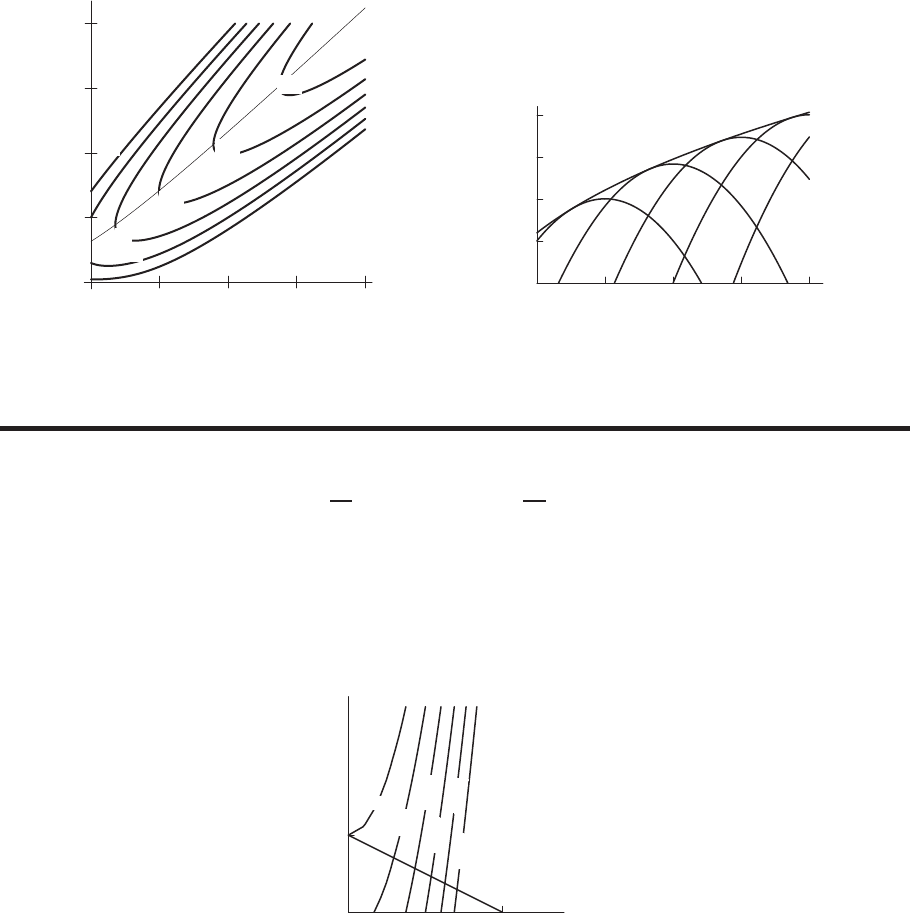
1436 Chapter Fifteen /SOLUTIONS
48. (a) The constraints x=care the vertical lines on the contour diagram of f. Maxima occur where a vertical line is
tangent to a contour. Four contours with vertical tangents are shown and we can imagine others. The curve we want
is shown in Figure 15.31.
(b) The constraints x=care the vertical lines on the graph of cross-sections of f. Since fis on the vertical axis, the
maximum value of fon the constraint occurs on the cross section that crosses the constraint at the highest point. Not
all cross-sections are shown, so we imagine the others to find the highest point. The curve we want goes across the
top of all the cross-sections, as shown in Figure 15.32.
(c) The curve in part (b) shows the maximum value of fas a function of the constraining value x=c. Since the Lagrange
multiplier λis the rate of change of the maximum value of fwith respect to c, the value of λis the slope of that
envelope curve.
1 2 3 4
1
2
3
4
8
11
14
17
5
2
x
y
Figure 15.31
1 2 3 4
0
5
10
15
20
y= 1
y= 2
y= 3
y= 4
y= 5
x
z
Figure 15.32
Strengthen Your Understanding
49. Let g(x, y) = x+y. The critical points occur where
∂f
∂x =y=λand ∂f
∂y =x=λ.
Thus x=y. Since the critical point must lie on the line x+y= 2, we have x=y= 1.
The value of fdecreases as we move away from (1,1), so (1,1) is the maximum on the constraint. The maximum
value of fis f(1,1) = 1.
50. The maximum value of fcan occur at the endpoints. For example, the level curves of fin Figure 15.33 show that fhas
a maximum at (0,3) even though the level curves of fare nowhere tangent to the constraint.
6
3
6
−2
−10
−26
−18
−34
x
y
Figure 15.33

15.3 SOLUTIONS 1437
51. It is helpful to think of a contour diagram for f. For example, if the contours are all parallel with the highest contour
tangent to x2+y2= 5 at (3,4), that would work. Since the tangent at (3,4) has normal 3
~
i+ 4~
j, this suggests the linear
function f(x, y) = 3x+ 4y
52. Let fbe any function having a global minimum at (0,0), for example f(x, y) = x2+y2.
53. Let f(x, y) = x2+y2. Then
grad f= 2x
~
i+ 2y~
j .
So at (1,1),
grad f= 2
~
i+ 2~
j .
If g(x, y) = x+y,
grad f= 2 grad g.
The point (1,1) is a critical point. It is a minimum on the line x+y= 2 since the value of fincreases without bound as
we move away from (1,1).
54. Let f(x, y) = 10 −x2−y2. Then
grad f=−2x
~
i−2y~
j .
If g(x, y) = x+y, then
grad g=~
i+~
j .
Then grad f=λgrad ggives
−2x=λ
−2y=λ.
So, x=yand since x+y= 4, we have x=y= 2.
Thus f(x, y) = 10 −x2−y2has a critical point at (2,2). This point gives a maximum. There is no minimum value
as fdecreases as we go away from (2,2).
55. The constraint is the line segment in the first quadrant joining the points (0,3) and (6,0). A possible contour diagram is
shown in Figure 15.34. The maximum value of fis 6at the point (0,3), an endpoint of the constraint.
6
3
6
−2
−10
−26
−18
−34
x
y
Figure 15.34
56. The maximum is f= 4 and occurs at (0,4). The minimum is f= 2 and occurs at about (4,2).
57. The maximum is f= 4 and occurs at (0,4). The minimum is f= 0 and occurs at the origin.
58. True. The point (a, b)must lie on the constraint g(x, y) = c, so g(a, b) = c.
59. False. The point (a, b)is not necessarily a critical point of f, since it is a constrained extremum.
60. True. The constraint is the same as x=y, so along the constraint f= 2x, which grows without bound as x→ ∞.
61. False. The condition grad f=λgrad gyields the two equations 1 = λ2xand 2 = λ2y. Substituting x= 2 in the first
equation gives λ= 1/4, while setting y=−1in the second gives λ=−1, so the point (2,−1) is not a local extremum
of fconstrained to x+ 2y= 0.

1438 Chapter Fifteen /SOLUTIONS
62. False. Since grad fand grad gpoint in opposite directions, they are parallel. Therefore (a, b)could be a local maximum
or local minimum of fconstrained to g=c. However the information given is not enough to determine that it is a
minimum. If the contours of gnear (a, b)increase in the opposite direction as the contours of f, then at a point with
grad f(a, b) = λgrad g(a, b)we have λ≤0, but this can be a local maximum or minimum.
For example, f(x, y) = 4 −x2−y2has a local maximum at (1,1) on the constraint g(x, y) = x+y= 2.Yet at
this point, grad f=−2
~
i−2~
jand grad g=~
i+~
j, so grad fand grad gpoint in opposite directions.
63. False. A maximum for fsubject to a constraint need not be a critical point of f
64. False. The condition for the Lagrange multiplier λis grad f(a, b) = λgrad g(a, b).
65. False. Just as a critical point need not be a maximum or minimum for unconstrained optimization, a point satisfying the
Lagrange condition need not be a maximum or minimum for a constrained optimization.
66. True. Since f(a, b) = M, we must satisfy the Lagrange conditions that fx(a, b) = λg(a, b)and fy(a, b) = λgy(a, b),
for some λ. Thus fx(a, b)/fy(a, b) = gx(a, b)/gy(a, b).
67. True. Since f(a, b) = m, the point (a, b)must satisfy the Lagrange condition that fx(a, b) = λg(a, b), for some λ. In
particular, if gx(a, b) = 0, then fx(a, b) = 0.
68. False. Whether increasing cwill increase Mdepends on the sign of λat a point (a, b)where f(a, b) = M
69. True. The value of λat a maximum point gives the proportional change in Mfor a change in c.
70. False. The value of λat a minimum point gives the proportional change in mfor a change in c. If λ > 0and the change
in cis positive, the change in mwill also be positive.
Solutions for Chapter 15 Review
Exercises
1. At a critical point,
fx= 2x+ 2y−4 = 0
fy= 2x−2y−8 = 0
Solving these equations gives, the critical point x= 3,y=−1. To classify the critical point, we find
D=fxxfyy −(fxy )2= 2(−2) −22=−8.
Since D < 0, we have a saddle point at (3,−1).
2. The critical points of fare obtained by solving fx=fy= 0, that is
fx(x, y) = 2y2−2x= 0 and fy(x, y) = 4xy −4y= 0,
so
2(y2−x) = 0 and 4y(x−1) = 0
The second equation gives either y= 0 or x= 1. If y= 0 then x= 0 by the first equation, so (0,0) is a critical point. If
x= 1 then y2= 1 from which y= 1 or y=−1, so two further critical points are (1,−1), and (1,1).
Since
D=fxxfyy −(fxy )2= (−2)(4x−4) −(4y)2= 8 −8x−16y2,
we have
D(0,0) = 8 >0, D(1,1) = D(1,−1) = −16 <0,
and fxx =−2<0. Thus, (0,0) is a local maximum; (1,1) and (1,−1) are saddle points.
3. To find the critical points, we solve fx= 0 and fy= 0 for xand y. Solving
fx= 3x2−6x= 0
fy= 2y+ 10 = 0
shows that x= 0 or x= 2 and y=−5. There are two critical points: (0,−5) and (2,−5).
We have
D= (fxx)(fyy )−(fxy )2= (6x−6)(2) −(0)2= 12x−12.
When x= 0, we have D=−12 <0, so fhas a saddle point at (0,−5). When x= 2, we have D= 12 >0and
fxx = 6 >0, so fhas a local minimum at (2,−5).
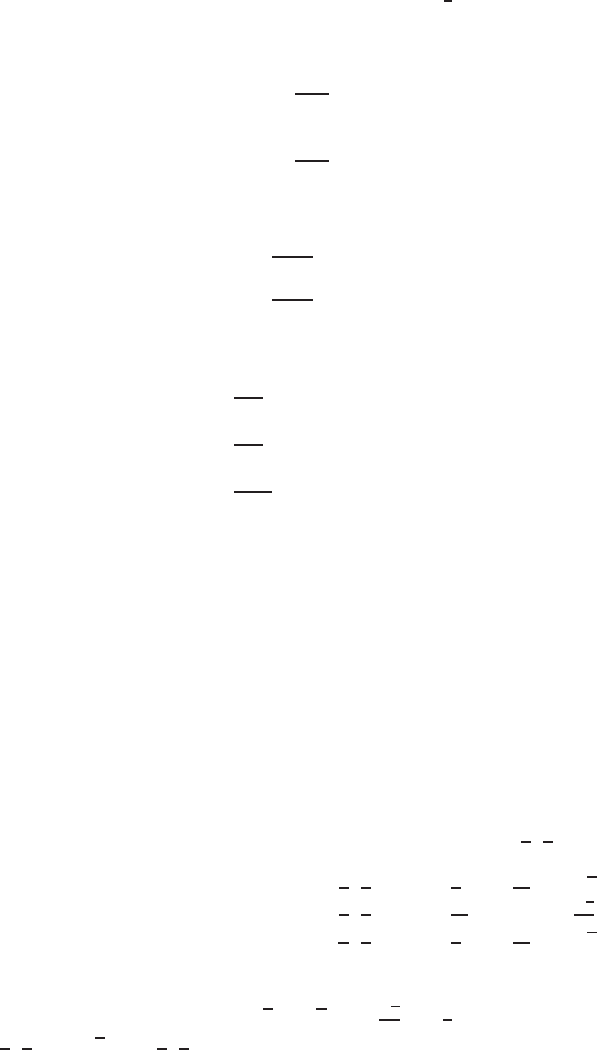
SOLUTIONS to Review Problems for Chapter Fifteen 1439
4. At a critical point
fx(x, y) = 2xy −2y= 0
fy(x, y) = x2+ 4y−2x= 0.
From the first equation, 2y(x−1) = 0, so either y= 0 or x= 1. If y= 0, then x2−2x= 0, so x= 0 or x= 2. Thus
(0,0) and (2,0) are critical points. If x= 1, then 12+ 4y−2 = 0, so y= 1/4. Thus (1,1/4) is a critical point. Now
D=fxxfyy −(fxy )2= 2y·4−(2x−2)2= 8y−4(x−1)2,
so
D(0,0) = −4, D(2,0) = −4, D(1,1
4) = 2
so (0,0) and (2,0) are saddle points. Since fyy = 4 >0, we see that (1,1/4) is a local minimum.
5. Critical points occur where fx=fy= 0:
fx(x, y) = −80
x2y+ 10 + 10y.
fy(x, y) = −80
xy2+ 10x+ 20.
Substituting x= 2,y= 1 gives
fx(2,1) = −80
22·1+ 10 + 10.1 = 0
fy(2,1) = −80
2·12+ 10.2 + 20 = 0.
So (2,1) is a critical point.
To determine if this critical point is a minimum we use the second derivative test.
fxx =160
x3y, fxx(2,1) = 20,
fyy =160
xy3, fyy (2,1) = 80,
fxy =80
x2y2+ 10, fxy(2,1) = 30.
So D= 20 ·80 −302= 700 >0and fxx(2,1) >0, therefore the point (2,1) is a local minimum.
6. The partial derivatives are
fx= cos x+ cos (x+y).
fy= cos y+ cos (x+y).
Setting fx= 0 and fy= 0 gives
cos x= cos y
For 0< x < π and 0< y < π,cos x= cos yonly if x=y. Then, setting fx=fy= 0:
cos x+ cos 2x= 0,
cos x+ 2 cos2x−1 = 0,
(2 cos x−1)(cos x+ 1) = 0.
So cos x= 1/2or cos x=−1, that is x=π/3or x=π. For the given domain 0< x < π,0< y < π, we only
consider the solution when x=π/3then y=x=π/3. Therefore, the critical point is (π
3,π
3).
Since
fxx(x, y) = −sin x−sin (x+y)fxx(π
3,π
3) = −sin π
3−sin 2π
3=−√3
fxy (x, y) = −sin (x+y)fxy(π
3,π
3) = −sin 2π
3=−√3
2
fyy (x, y) = −sin y−sin (x+y)fyy (π
3,π
3) = −sin π
3−sin 2π
3=−√3
the discriminant is
D(x, y) = fxxfyy −f2
xy
= (−√3)(−√3) −(−√3
2)2=9
4>0.
Since fxx(π
3,π
3) = −√3<0,(π
3,π
3)is a local maximum.
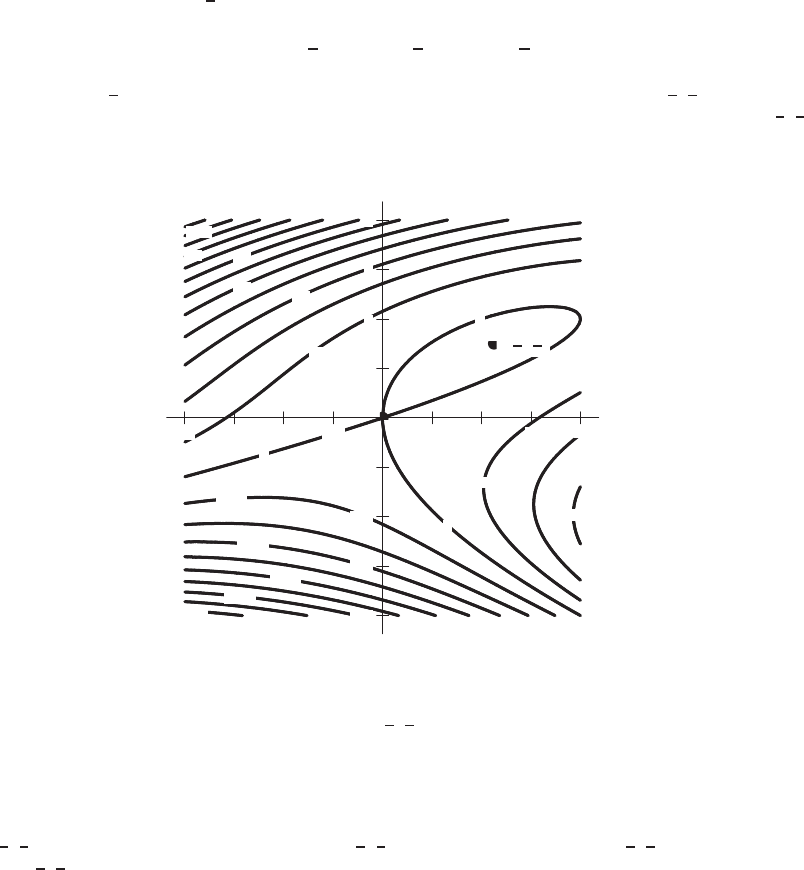
1440 Chapter Fifteen /SOLUTIONS
7. We find critical points:
fx(x, y) = 12 −6x= 0
fy(x, y) = 6 −2y= 0
so (2,3) is the only critical point. At this point
D=fxxfyy −(fxy )2= (−6)(−2) = 12 >0,
and fxx <0, so (2,3) is a local maximum. Since this is a quadratic, the local maximum is a global maximum.
Alternatively, we complete the square, giving
f(x, y) = 10 −3(x2−4x)−(y2−6y) = 31 −3(x−2)2−(y−3)2.
This expression for fshows that its maximum value (which is 31) occurs where x= 2, y = 3.
8. The partial derivatives are fx= 2x−3y, fy= 3y2−3x. For critical points, solve fx= 0 and fy= 0 simultaneously.
From 2x−3y= 0 we get x=3
2y. Substituting it into 3y2−3x= 0, we have that
3y2−3( 3
2y) = 3y2−9
2y=y(3y−9
2) = 0.
So y= 0 or 3y−9
2= 0, that is, y= 0 or y= 3/2. Therefore the critical points are (0,0) and (9
4,3
2).
The contour diagram for fin Figure 15.35 (drawn by a computer), shows that (0,0) is a saddle point and that (9
4,3
2)is a
local minimum.
−4−3−2−1 1 2 3 4
−4
−3
−2
−1
1
2
3
4
110
90 70
50 30
10
−10
−30
−50
−70
−90
10
30
0
0
0
x
y
(9
4,3
2)
Figure 15.35
: Contour map of f(x, y) = x2+y3−3xy
We can also see that (0,0) is a saddle point and (9
4,3
2)is a local minimum analytically. Since fxx = 2, fyy =
6y, fxy =−3, the discriminant is
D(x, y) = fxxfyy −f2
xy = 12y−(−3)2= 12y−9.
D(0,0) = −9<0, so (0,0) is a saddle point.
D(9
4,3
2) = 9 >0and fxx = 2 >0,we know that (9
4,3
2)is a local minimum. The point (9
4,3
2)is not a global minimum
since f(9
4,3
2) = −1.6875, whereas f(0,−2) = −8.
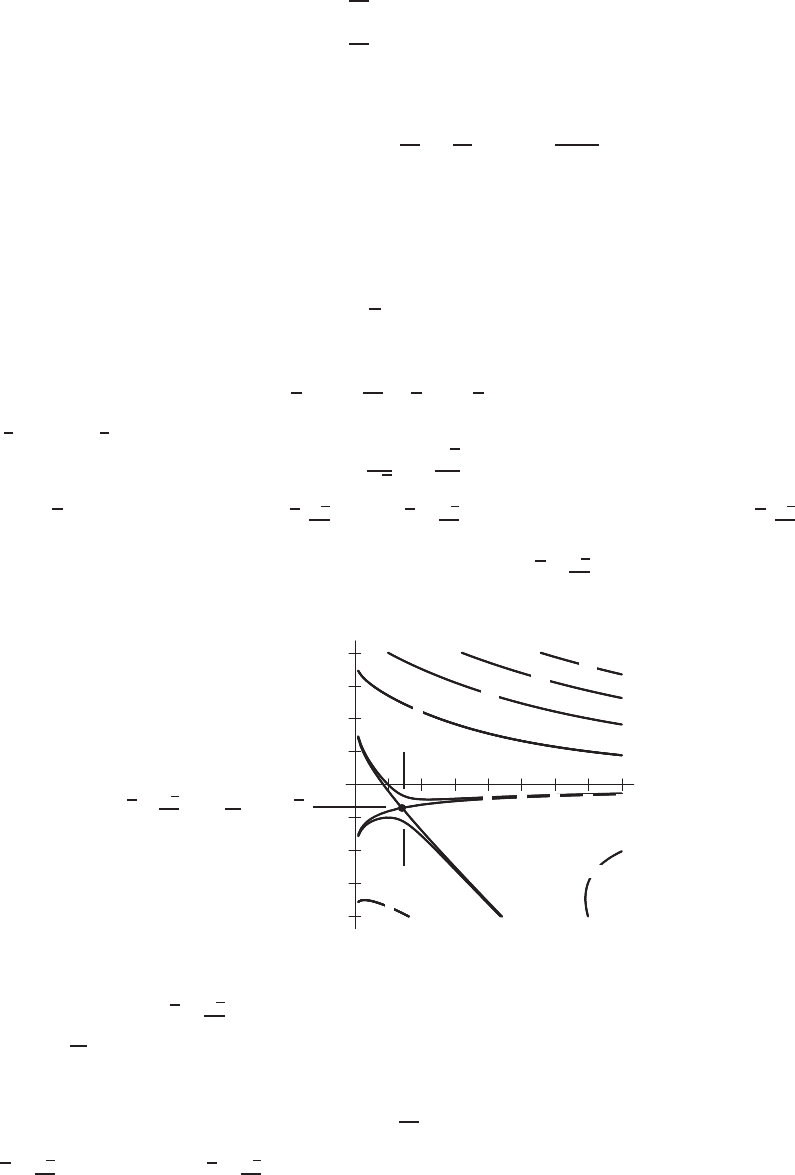
SOLUTIONS to Review Problems for Chapter Fifteen 1441
9. Note that the x-axis and the y-axis are not in the domain of f. Since x6= 0 and y6= 0, by setting fx= 0 and fy= 0 we
get
fx= 1 −1
x2= 0 when x=±1
fy= 1 −4
y2= 0 when y=±2
So the critical points are (1,2),(−1,2),(1,−2),(−1,−2). Since fxx = 2/x3and fyy = 8/y3and fxy = 0, the
discriminant is
D(x, y) = fxxfyy −f2
xy =2
x38
y3−02=16
(xy)3.
Since D < 0at the points (−1,2) and (1,−2), these points are saddle points. Since D > 0at (1,2) and (−1,−2) and
fxx(1,2) >0and fxx(−1,−2) <0, the point (1,2) is a local minimum and the point (−1,−2) is a local maximum.
No global maximum or minimum, since f(x, y)increases without bound if xand yincrease in the first quadrant; f(x, y)
decreases without bound if xand ydecrease in the third quadrant.
10. The partial derivatives are
fx=y+1
x, fy=x+ 2y.
For critical points, solve fx= 0 and fy= 0 simultaneously. From fy=x+ 2y= 0 we get that x=−2y. Substituting
into fx= 0, we have
y+1
x=y−1
2y=1
y(y2−1
2) = 0
Since 1
y6= 0,y2−1
2= 0, therefore
y=±1
√2=±√2
2,
and x=∓√2. So the critical points are −√2,√2
2and √2,−√2
2. But xmust be greater than 0, so −√2,√2
2is
not in the domain.
The contour diagram for fin Figure 15.36 (drawn by computer), shows that √2,−√2
2is a saddle point of f(x, y).
45678
−4
−3
−2
−1
1
2
3
4
x
y
0
❄
−10
✻
−10
✲
f(√2,−√2
2) = −21
2+ ln √2
−20
0
10
20 30
Figure 15.36
: Contour map of f(x, y) = xy + ln x+y2−10
We can also see that √2,−√2
2is a saddle point analytically.
Since fxx =−1
x2, fyy = 2, fxy = 1, the discriminant is:
D(x, y) = fxxfyy −f2
xy
=−2
x2−1.
D√2,−√2
2=−2<0, so √2,−√2
2is a saddle point.

1442 Chapter Fifteen /SOLUTIONS
11. The objective function is f(x, y) = 3x−4yand the constraint equation is g(x, y) = x2+y2= 5, so grad f= 3
~
i−4~
j
and grad g= (2x)
~
i+ (2y)~
j. Setting grad f=λgrad ggives
3 = λ(2x),
−4 = λ(2y).
From the first equation we have λ= 3/(2x), and from the second equation we have λ=−2/y. Setting these equal gives
x=−3
4y.
Substituting this into the constraint equation x2+y2= 5 gives y2= 16/5, so y= 4/√5and y=−4/√5. Since
x=−3
4y, there are two points where a maximum or a minimum might occur:
(−3/√5,4/√5) and (3/√5,−4/√5).
Since the constraint is closed and bounded, maximum and minimum values of fsubject to the constraint exist. Since
f(−3/√5,4/√5) = −5√5and f(3/√5,−4/√5) = 5√5, we see that fhas a minimum value at (−3/√5,4/√5) and
a maximum value at (3/√5,−4/√5).
12. The objective function is f(x, y) = x2+y2and the equation of constraint is g(x, y) = x4+y4= 2. Their gradients are
∇f(x, y) = 2x
~
i+ 2y~
j ,
∇g(x, y) = 4x3
~
i+ 4y3~
j .
So the equation ∇f=λ∇gbecomes 2x
~
i+ 2y~
j=λ(4x3
~
i+ 4y3~
j). This tells us that
2x= 4λx3,
2y= 4λy3.
Now if x= 0, the first equation is true for any value of λ. In particular, we can choose λwhich satisfies the second
equation. Similarly, y= 0 is solution.
Assuming both x6= 0 and y6= 0, we can divide to solve for λand find
λ=2x
4x3=2y
4y3
1
2x2=1
2y2
y2=x2
y=±x.
Going back to our equation of constraint, we find
g(0, y) = 04+y4= 2,so y=±4
√2
g(x, 0) = x4+ 04= 2,so x=±4
√2
g(x, ±x) = x4+ (±x)4= 2,so x=±1.
Thus, the critical points are (0,±4
√2),(±4
√2,0),(1,±1) and (−1,±1). Since the constraint is closed and bounded,
maximum and minimum values of fsubject to the constraint exist. Evaluating fat the critical points, we find
f(1,1) = f(1,−1) = f(−1,1) = f(−1,−1) = 2,
f(0,4
√2) = f(0,−4
√2) = f(4
√2,0) = f(−4
√2,0) = √2.
Thus, the minimum value of f(x, y)on g(x, y) = 2 is √2and the maximum value is 2.
13. The objective function is f(x, y) = x2+y2and the constraint equation is g(x, y) = 4x−2y= 15, so grad f=
(2x)
~
i+ (2y)~
jand grad g= 4
~
i−2~
j. Setting grad f=λgrad ggives
2x= 4λ,
2y=−2λ.
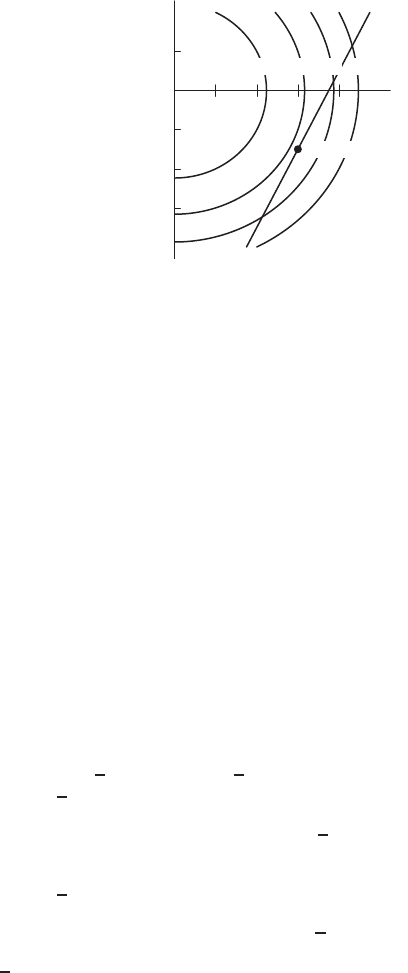
SOLUTIONS to Review Problems for Chapter Fifteen 1443
From the first equation we have λ=x/2, and from the second equation we have λ=−y. Setting these equal gives
y=−0.5x.
Substituting this into the constraint equation 4x−2y= 15 gives x= 3. The only critical point is (3,−1.5).
We have f(3,−1.5) = (3)2+ (1.5)2= 11.25. One way to determine if this point gives a maximum or minimum
value or neither for the given constraint is to examine the contour diagram of fwith the constraint sketched in, Fig-
ure 15.37. It appears that moving away from the point P= (3,−1.5) in either direction along the constraint increases the
value of f, so (3,−1.5) is a point of minimum value.
1234
5 10 15 20
−3
−2
−1
1
Constraint:
4x−2y= 15
P= (3,−1.5)
x
y
Figure 15.37
14. The objective function is f(x, y) = x2−xy +y2and the equation of constraint is g(x, y) = x2−y2= 1. The gradients
of fand gare
∇f(x, y) = (2x−y)
~
i+ (−x+ 2y)~
j ,
∇g(x, y) = 2x
~
i−2y~
j .
Therefore the equation ∇f(x, y) = λ∇g(x, y)gives
2x−y= 2λx
−x+ 2y=−2λy
x2−y2= 1.
Let us suppose that λ= 0. Then 2x=yand 2y=xgive x=y= 0. But (0,0) is not a solution of the third equation,
so we conclude that λ6= 0. Now let’s multiply the first two equations
−2λy(2x−y) = 2λx(−x+ 2y).
As λ6= 0, we can cancel it in the equation above and after doing the algebra we get
x2−4xy +y2= 0
which gives x= (2 + √3)yor x= (2 −√3)y.
If x= (2 + √3)y, the third equation gives
(2 + √3)2y2−y2= 1
so y≈ ±0.278 and x≈ ±1.038. These give the critical points (1.038,0.278),(−1.038,−0.278).
If x= (2 −√3)y, from the third equation we get
(2 −√3)2y2−y2= 1.
But (2 −√3)2−1≈ −0.928 <0so the equation has no solution. Evaluating fgives
f(1.038,0.278) = f(−1.038,−0.278) ≈0.866
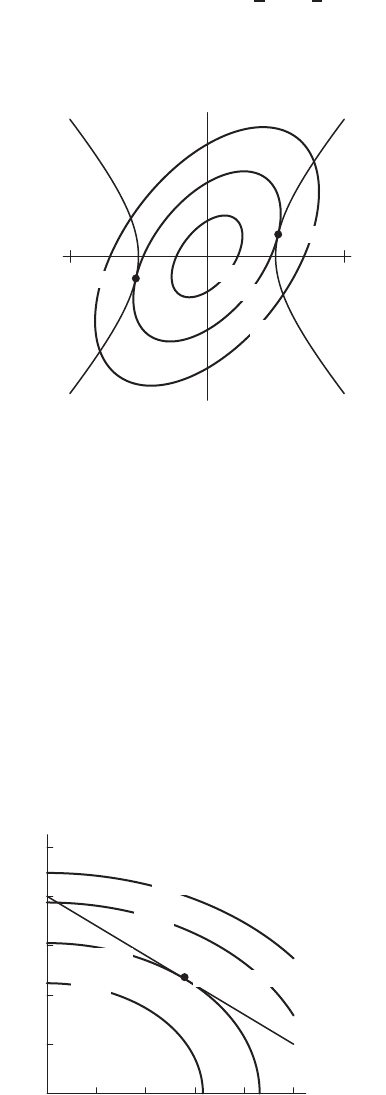
1444 Chapter Fifteen /SOLUTIONS
Since y→ ∞ on the constraint, rewriting fas
f(x, y) = x−y
22
+3
4y2
shows that fhas no maximum on the constraint. The minimum value of fis 0.866. See Figure 15.38.
−2
2
(1.038,0.278)
(−1.038,−0.278) 0.2
0.866
2
x
x2−y2= 1
y
Figure 15.38
15. The objective function is f(x, y) = x2+ 2y2and the constraint equation is g(x, y) = 3x+ 5y= 200, so grad f=
(2x)
~
i+ (4y)~
jand grad g= 3
~
i+ 5~
j. Setting grad f=λgrad ggives
2x= 3λ,
4y= 5λ.
From the first equation, we have λ= 2x/3, and from the second equation we have λ= 4y/5. Setting these equal gives
x= 1.2y.
Substituting this into the constraint equation 3x+ 5y= 200 gives y= 23.256. Since x= 1.2y, we have x= 27.907. A
maximum or minimum value of fcan occur only at (27.907,23.256).
We have f(27.907,23.256) = 1860.484. From Figure 15.39, we see that the point (27.907,23.256) is a minimum
value of fsubject to the given constraint.
10 20 30 40 50
10
20
30
40
50
1000
1860
3000
4000
(27.9,23.6)
x
3x+ 5y= 200
y
Figure 15.39

SOLUTIONS to Review Problems for Chapter Fifteen 1445
16. Our objective function is f(x, y) = xy and our equation of constraint is g(x, y) = 4x2+y2= 8. Their gradients are
∇f(x, y) = y~
i+x~
j ,
∇g(x, y) = 8x
~
i+ 2y~
j .
So the equation ∇f=λ∇gbecomes y~
i+x~
j=λ(8x
~
i+ 2y~
j). This gives
8xλ =yand 2yλ =x.
Multiplying, we get
8x2λ= 2y2λ.
If λ= 0, then x=y= 0, which does not satisfy the constraint equation. So λ6= 0 and we get
2y2= 8x2
y2= 4x2
y=±2x.
To find x, we substitute for yin our equation of constraint.
4x2+y2= 8
4x2+ 4x2= 8
x2= 1
x=±1
So our critical points are (1,2),(1,−2),(−1,2) and (−1,−2). Since the constraint is closed and bounded, maximum
and minimum values of fsubject to the constraint exist. Evaluating f(x, y)at the critical points, we have
f(1,2) = f(−1,−2) = 2
f(1,−2) = f(1,−2) = −2.
Thus, the maximum value of fon g(x, y) = 8 is 2, and the minimum value is −2.
17. We will use the Lagrange multipliers with:
Objective function: f(x, y) = −3x2−2y2+ 20xy
Constraint: g(x, y) = x+y−100
We first find
∇f= (−6x+ 20y)
~
i+ (−4y+ 20x)~
j
∇g=~
i+~
j .
To optimize f, we must solve the equations
∇f=λ∇g
(−6x+ 20y)
~
i+ (−4y+ 20x)~
j=λ(
~
i+~
j) = λ
~
i+λ~
j
We have a vector equation, so we equate the coordinates:
−6x+ 20y=λ
20x−4y=λ.
So −6x+ 20y= 20x−4y
24y= 26x
y=13
12 x
Substituting into the constraint equation x+y= 100, we obtain:
x+13
12 x= 100
25
12 x= 100
x= 48.
Consequently, y= 52, and f(48,52) = 37,600. The point (48,52) leads to the extreme value of f(x, y), given that
x+y= 100. Note that fhas no minimum on the line x+y= 100 since f(x, 100 −x) = −3x2−2(100 −x)2+
20x(100 −x) = −25x2+ 2400x−20000 which goes to −∞ as xgoes to ±∞. Therefore, the point (48,52) gives the
maximum value for fon the line x+y= 100.

1446 Chapter Fifteen /SOLUTIONS
18. Our objective function is f(x, y, z) = x2−2y+ 2z2and our equation of constraint is g(x, y, z) = x2+y2+z2−1 = 0.
To optimize f(x, y, z)with Lagrange multipliers, we solve ∇f(x, y, z) = λ∇g(x, y, z)subject to g(x, y, z) = 0. The
gradients of fand gare
∇f(x, y, z) = 2x
~
i−2~
j+ 4z~
k ,
∇g(x, y) = 2x
~
i+ 2y~
j+ 2z~
k .
We get,
x=λx
−1 = λy
2z=λz
x2+y2+z2= 1.
From the first equation we get x= 0 or λ= 1.
If x= 0 we have
−1 = λy
2z=λz
y2+z2= 1.
From the second equation z= 0 or λ= 2. So if z= 0, we have y=±1and we get the solutions (0,1,0),(0,−1,0). If
z6= 0 then λ= 2 and y=−1
2. So z2=3
4which gives the solutions (0,−1
2,√3
2),(0,−1
2,−√3
2).
If x6= 0, then λ= 1, so y=−1, which implies, from the equation x2+y2+z2= 1, that x= 0, which contradicts
the assumption.
Since the constraint is closed and bounded, maximum and minimum values of fsubject to the constraint exist. There-
fore, evaluating fat the critical points, we get f(0,1,0) = −2,f(0,−1,0) = 2 and f(0,−1
2,√3
2) = f(0,−1
2,−√3
2) =
5
2. So the maximum value of fis 5
2and the minimum is −2.
19. Our objective function is f(x, y, z) = 2x+y+ 4zand our equation of constraint is g(x, y, z) = x2+y+z2= 16.
Their gradients are
∇f(x, y, z) = 2
~
i+ 1~
j+ 4~
k ,
∇g(x, y, z) = 2x
~
i+ 1~
j+ 2z~
k .
So the equation ∇f=λ∇gbecomes 2
~
i+ 1~
j+ 4~
k=λ(2x
~
i+ 1~
j+ 2z~
k). Solving for λwe find
λ=2
2x=1
1=4
2z
λ=1
x= 1 = 2
z.
Which tells us that x= 1 and z= 2. Going back to our equation of constraint, we can solve for y.
g(1, y, 2) = 16
12+y+ 22= 16
y= 11.
So our one critical point is at (1,11,2). The value of fat this point is f(1,11,2) = 2 + 11 + 8 = 21. This is the
maximum value of f(x, y, z)on g(x, y, z) = 16. To see this, note that for y= 16 −x2−z2,
f(x, y, z) = 2x+ 16 −x2−z2+ 4z= 21 −(x−1)2−(z−2)2≤21.
As y→ −∞, the point (−√16 −y, y, 0) is on the constraint and f(−√16 −y, y, 0) → −∞, so there is no minimum
value for f(x, y, z)on g(x, y, z) = 16.
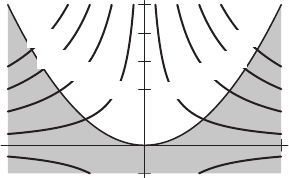
SOLUTIONS to Review Problems for Chapter Fifteen 1447
20. We first find the critical points in the disk
∇z= (8x−y)
~
i+ (8y−x)~
j
Setting ∇z= 0 gives 8x−y= 0 and 8y−x= 0. The only solution is x=y= 0. So (0,0) is the only critical point in
the disk.
Next we find the extremal values on the boundary using Lagrange multipliers. We have objective function z=
4x2−xy + 4y2and constraint G=x2+y2−2 = 0.
∇z= (8x−y)
~
i+ (8y−x)~
j
∇G= 2x
~
i+ 2y~
j
∇z=λ∇Ggives
8x−y= 2λx
8y−x= 2λy
If λ= 0 we get
8x−y= 0
8y−x= 0
with only solutions x=y= 0, which does not satisfy the constraint: x2+y2−2 = 0. Therefore λ6= 0 and we get:
2λy(8x−y) = 2λx(8y−x)
and
y(8x−y) = x(8y−x).
So x2=y2,x=±y.
Substitute into G= 0, we get 2x2−2 = 0 so x=±1. The extremal points on the boundary are therefore
(1,1),(1,−1),(−1,1),(−1,−1). The region x2+y2≤2is closed and bounded, so minimum values of fin the region
exist. We check the values of zat these points :
z(1,1) = 7, z(−1,−1) = 7, z(1,−1) = 9, z(−1,1) = 9, z(0,0) = 0
Thus (−1,1) and (1,−1) give the maxima over the closed disk and (0,0) gives the minimum.
21. The region x2≥yis the shaded region in Figure 15.40 which includes the parabola y=x2.
10
30 50
−10
−30
−50
70
−70
x
y
Figure 15.40
We first want to find the local maxima and minima of fin the interior of our region. So we need to find the extrema
of
f(x, y) = x2−y2,in the region x2> y.
For this we compute the critical points:
fx= 2x= 0
fy=−2y= 0.

1448 Chapter Fifteen /SOLUTIONS
As (0,0) does not belong to the region x2> y, we have no critical points. Now let’s find the local extrema of fon
the boundary of our region, hence this time we have to solve a constraint problem. We want to find the extrema of
f(x, y) = x2−y2subject to g(x, y) = x2−y= 0. We use Lagrange multipliers:
grad f=λgrad gand x2=y.
This gives
2x= 2λx
2y=λ
x2=y.
From the first equation we get x= 0 or λ= 1.
If x= 0, from the third equation we get y= 0, so one solution is (0,0). If x6= 0, then λ= 1 and from the second
equation we get y=1
2. This gives x2=1
2so the solutions (1
√2,1
2)and (−1
√2,1
2).
So f(0,0) = 0 and f(1
√2,1
2) = f(−1
√2,1
2) = 1
4. From Figure 15.40 showing the level curves of fand the region
x2≥y, we see that (0,0) is a local minimum of fon x2=y, but not a global minimum and that (1
√2,1
2)and (−1
√2,1
2)
are global maxima of fon x2=ybut not global maxima of fon the whole region x2≥y.
So there are no global extrema of fin the region x2≥y.
22. The region x2+y2≤1is the shaded disk of radius 1centered at the origin (including the circle x2+y2= 1) shown in
Figure 15.41.
Let’s first compute the critical points of fin the interior of the disk. We have
fx= 3x2= 0
fy=−2y= 0,
whose solution is x=y= 0. So the only one critical point is (0,0). As fxx(0,0) = 0,fyy (0,0) = −2and fxy (0,0) =
0,
D=fxx(0,0) ·fyy (0,0) −(fxy (0,0))2= 0
which does not tell us anything about the nature of the critical point (0,0).
But, if we choose x,yvery small in absolute value and such that x3> y2, then f(x, y)>0. If we choose x,yvery
small in absolute value and such that x3< y2, then f(x, y)<0. As f(0,0) = 0, we conclude that (0,0) is a saddle
point.
We can get the same conclusion looking at the level curves of faround (0,0), as shown in Figure 15.42.
So, fdoes not have extrema in the interior of the disk.
Now, let’s find the local extrema of fon the circle x2+y2= 1. So we want the extrema of f(x, y) = x3−y2
subject to the constraint g(x, y) = x2+y2−1 = 0. Using Lagrange multipliers we get
grad f=λgrad gand x2+y2= 1,
which gives
3x2= 2λx
−2y= 2λy
x2+y2= 1.
From the second equation y= 0 or λ=−1.
If y= 0, from the third equation we get x2= 1, which gives the solutions (1,0),(−1,0).
If y6= 0 then λ=−1and from the first equation we get 3x2=−2x, hence x= 0 or x=−2
3. If x= 0, from the
third equation we get y2= 1, so the solutions (0,1),(0,−1). If x=−2
3, from the third equation we get y2=5
9, so the
solutions (−2
3,√5
3),(−2
3,−√5
3).
Evaluating fat these points we get
f(1,0) = 1, f(−1,0) = f(0,1) = f(0,−1) = −1
and
f−2
3,−√5
3=f−2
3,√5
3=−23
27 .
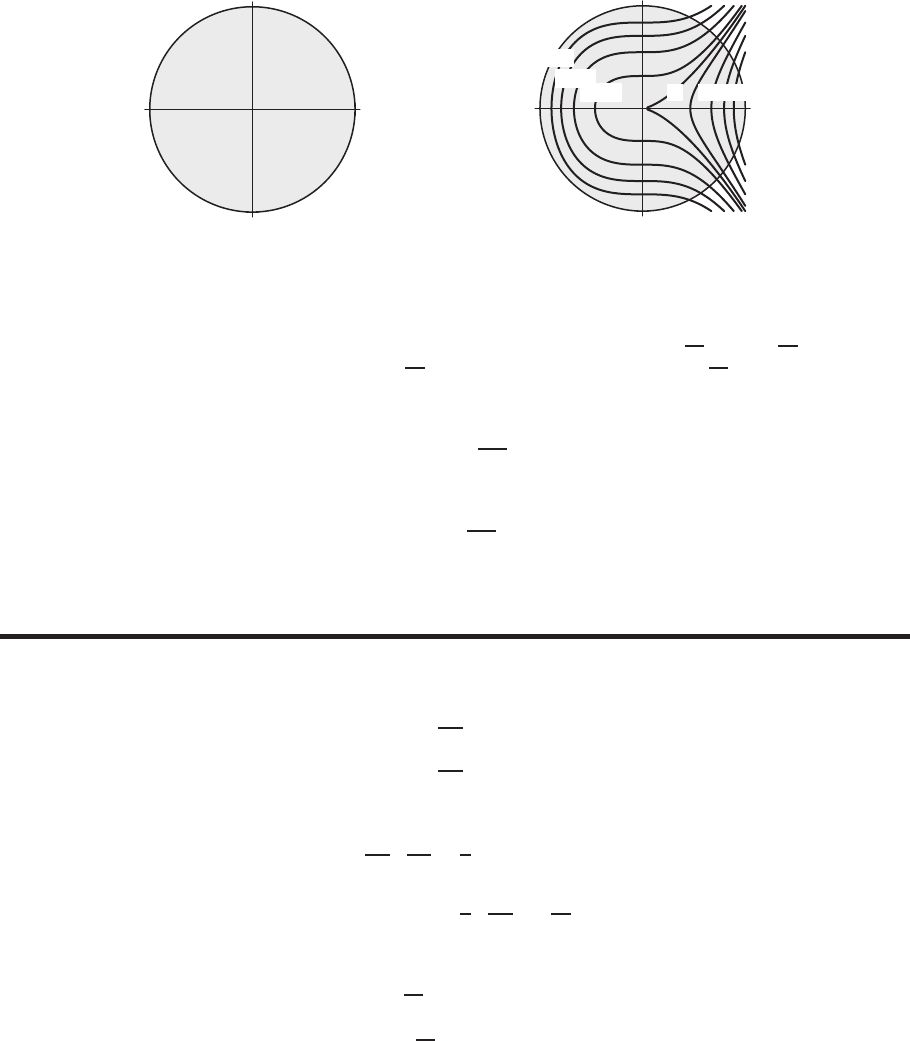
SOLUTIONS to Review Problems for Chapter Fifteen 1449
The region x2+y2≤1is closed and bounded, so maximum and minimum values of fin the region exist. Therefore
the maximum value of fis 1 and the minimum value is −1.
1
1
x
y
Figure 15.41
−1 1
−1
1
0 0.3 0.7
−0.1
−0.3
−0.7
x
y
Figure 15.42
: Level curves of f
23. If x= 10 then f(x, y) = 100 −y2is a parabola opening downward, so it has a maximum but no minimum.
24. If y= 10 then f(x, y) = x2−100 is a parabola opening upward, so it has a minimum but no maximum.
25. If x2+y2= 10, then f(x, y) = x2−y2= 2x2−10 and xhas values in the interval −√10 ≤x≤√10. Hence f(x, y)
has a maximum on the constraint at (x, y) = (±√10,0) and a minimum at (x, y) = (0,±√10).
26. If xy = 10, then f(x, y) = x2−y2=x2−100/x2and xcan take any nonzero value. Since
lim
x→∞ x2−100
x2=∞,
we see fhas no maximum on the constraint. Since
lim
x→0x2−100
x2=−∞,
we see fhas no minimum on the constraint.
Problems
27. The function f(x, y) = 0.3 ln x+ 0.7 ln yhas domain x > 0, y > 0.(It is not defined for x≤0or y≤0.)
At a critical point grad f=λgrad g, so
0.3
x= 2λ
0.7
y= 3λ.
Dividing gives
0.3
x·y
0.7=2
3
y=2
3·0.7
0.3x=14
9x.
Substituting into 2x+ 3y= 6 gives
2x+ 3 14
9x= 6
20
3x= 6 so x= 0.9.
Thus, y= 14(0.9)/9 = 1.4.
This is the only critical point on the constraint, and value of fdecreases toward −∞ as xor y→0.Thus (0.9,1.4)
gives the maximum:
f(0.9,1.4) = 0.3 ln(0.9) + 0.7 ln(1.4) = 0.204.
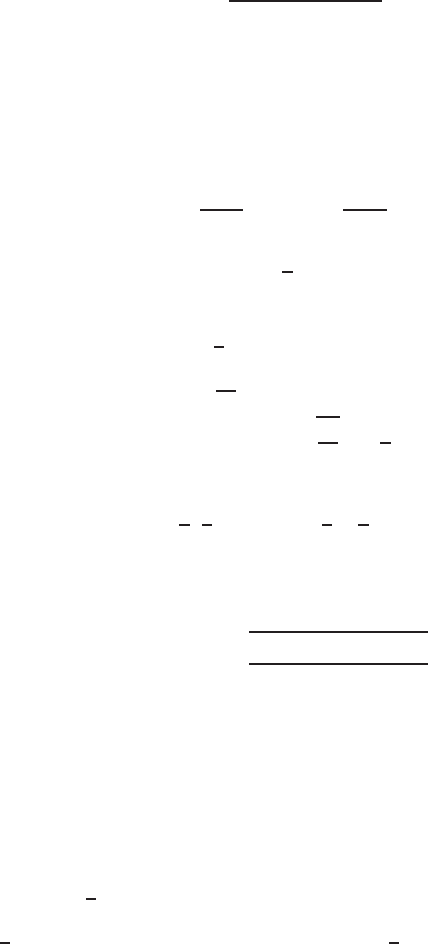
1450 Chapter Fifteen /SOLUTIONS
28. (a) The distance is
D=p(x−3)2+ (y−4)2.
(b) We want to minimize Dsubject to the constraint x2+y2= 1.The same values of xand ywhich minimize Dalso
minimize D2= (x−3)2+ (y−4)2,so we work with D2.Thus, at a critical point
grad(D2) = λgrad(x2+y2)
2(x−3) = 2λx
2(y−4) = 2λy
so we see λ6= 1 and
x=3
1−λand y=4
1−λ,
giving
y=4
3x·
Substituting into x2+y2= 1, we have
x2+4
3x2
= 1
25
9x2= 1
x=±r9
25 =±3
5.
Since y= 4x/3, the critical points are
3
5,4
5and −3
5,−4
5,
that is
(0.6,0.8) and (−0.6,−0.8),
The distances between (3,4) and these points are
D(0.6,0.8) = p(3 −0.6)2+ (4 −0.8)2= 4
D(−0.6,−0.8) = p(3 + 0.6)2+ (4 + 0.8)2= 6.
Thus, the minimum distance is 4 and occurs at (0.6,0.8).
(c) The maximum distance is 6 and occurs at (−0.6,−0.8).
29. The maximum and minimum values change by approximately λ∆c. The Lagrange conditions give:
2x=λ4x3,2y=λ4y3.
If x= 0, then y=±21/4from the constraint. If y= 0, then x=±21/4. If x6= 0 and y6= 0, we can solve for λand set
the expressions equal to get x2=y2, so y=±x.
Thus, there are eight points satisfying the Lagrange conditions: four of the form (0,±21/4)or (±21/4,0), and four
of the form (±1,±1). Since f(x, y) = x2+y2, we get a maximum value of 2at the four points of the form (±1,±1)
and a minimum value of 22/4=√2at the other four points. For the maximum value, we use λ= 1/(2x2) = 1/2, so
the change is approximately ∆c/2. For the minimum value at (0,±21/4), we use λ= 1/(2y2), so there the change is
approximately ∆c/(2√2). Similarly, the change at ±21/4,0) is also ∆c/(2√2).
30. Let the line be in the form y=b+mx. When xequals −1,0and 1, then yequals b−m,b, and b+m, respectively. The
sum of the squares of the vertical distances, which is what we want to minimize, is
f(m, b) = (2 −(b−m))2+ (−1−b)2+ (1 −(b+m))2.
To find the critical points, we compute the partial derivatives with respect to mand b,
fm= 2(2 −b+m) + 0 + 2(1 −b−m)(−1)
= 4 −2b+ 2m−2 + 2b+ 2m
= 2 + 4m,
fb= 2(2 −b+m)(−1) + 2(−1−b)(−1) + 2(1 −b−m)(−1)
=−4 + 2b−2m+ 2 + 2b−2 + 2b+ 2m
=−4 + 6b.
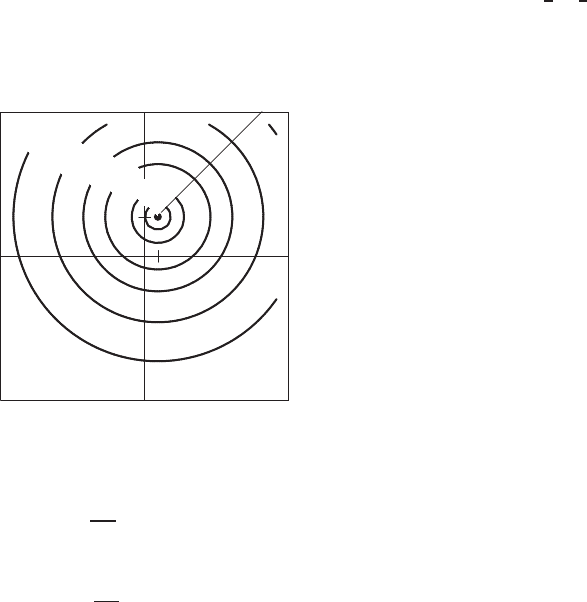
SOLUTIONS to Review Problems for Chapter Fifteen 1451
Setting both partial derivatives equal to zero, we get a system of equations:
2 + 4m= 0,
−4 + 6b= 0.
The solution is m=−1/2and b= 2/3. One can check that it is a minimum. Hence, the regression line is y=2
3−1
2x.
31. Since fxx <0and D=fxxfyy −f2
xy >0, the point (1,3) is a maximum. See Figure 15.43.
1
3
x
y
✠
0
−1
−4
−16
−32
−64
−120
Figure 15.43
32. At a local maximum value of f,
∂ f
∂ x =−2x−B= 0.
We are told that this is satisfied by x=−2. So −2(−2) −B= 0 and B= 4. In addition,
∂ f
∂ y =−2y−C= 0
and we know this holds for y= 1, so −2(1) −C= 0, giving C=−2. We are also told that the value of fis 15 at the
point (−2,1), so
15 = f(−2,1) = A−((−2)2+ 4(−2) + 12−2(1)) = A−(−5),so A= 10.
Now we check that these values of A,B, and Cgive f(x, y)a local maximum at the point (−2,1). Since
fxx(−2,1) = −2,
fyy(−2,1) = −2
and
fxy (−2,1) = 0,
we have that fxx(−2,1)fyy(−2,1) −f2
xy(−2,1) = (−2)(−2) −0>0and fxx(−2,1) <0. Thus, fhas a local
maximum value 15 at (−2,1).
33. (a) (i) Suppose N=kAp. Then the rule of thumb tells us that if Ais multiplied by 10, the value of Ndoubles. Thus
2N=k(10A)p=k10pAp.
Thus, dividing by N=kAp, we have
2 = 10p
so taking logs to base 10 we have
p= log 2 = 0.3010.
(where log 2 means log10 2). Thus,
N=kA0.3010.
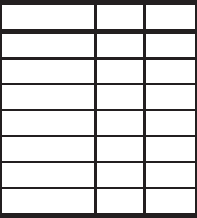
1452 Chapter Fifteen /SOLUTIONS
(ii) Taking natural logs gives
ln N= ln(kAp)
ln N= ln k+pln A
ln N≈ln k+ 0.301 ln A
Thus, ln Nis a linear function of ln A.
(b) Table 15.2 contains the natural logarithms of the data:
Table 15.2
ln Nand ln A
Island ln Aln N
Redonda 1.1 1.6
Saba 3.0 2.2
Montserrat 2.3 2.7
Puerto Rico 9.1 4.3
Jamaica 9.3 4.2
Hispaniola 11.2 4.8
Cuba 11.6 4.8
Using a least squares fit we find the line:
ln N= 1.20 + 0.32 ln A
This yields the power function:
N=e1.20A0.32 = 3.32A0.32
Since 0.32 is pretty close to log 2 ≈0.301, the answer does agree with the biological rule.
34. We want to minimize
C=f(q1, q2) = 2q2
1+q1q2+q2
2+ 500
subject to the constraint q1+q2= 200 or g(q1, q2) = q1+q2−200 = 0.
Since ∇f= (4q1+q2)
~
i+ (2q2+q1)~
jand ∇g=~
i+~
j,∇f=λ∇ggives
4q1+q2=λ
2q2+q1=λ.
Solving we get
4q1+q2= 2q2+q1
so
3q1=q2.
We want
q1+q2= 200
q1+ 3q1= 4q1= 200.
Therefore
q1= 50 units, q2= 150 units.
35. (a) Let g(x, y) = x+y. We are minimizing f(x, y) = x2+ 2y2subject to the constraint g(x, y) = c.
The method of Lagrange multipliers is to solve the equations
fx=λgxfy=λgyg=c,
which are
2x=λ4y=λ x +y=c.
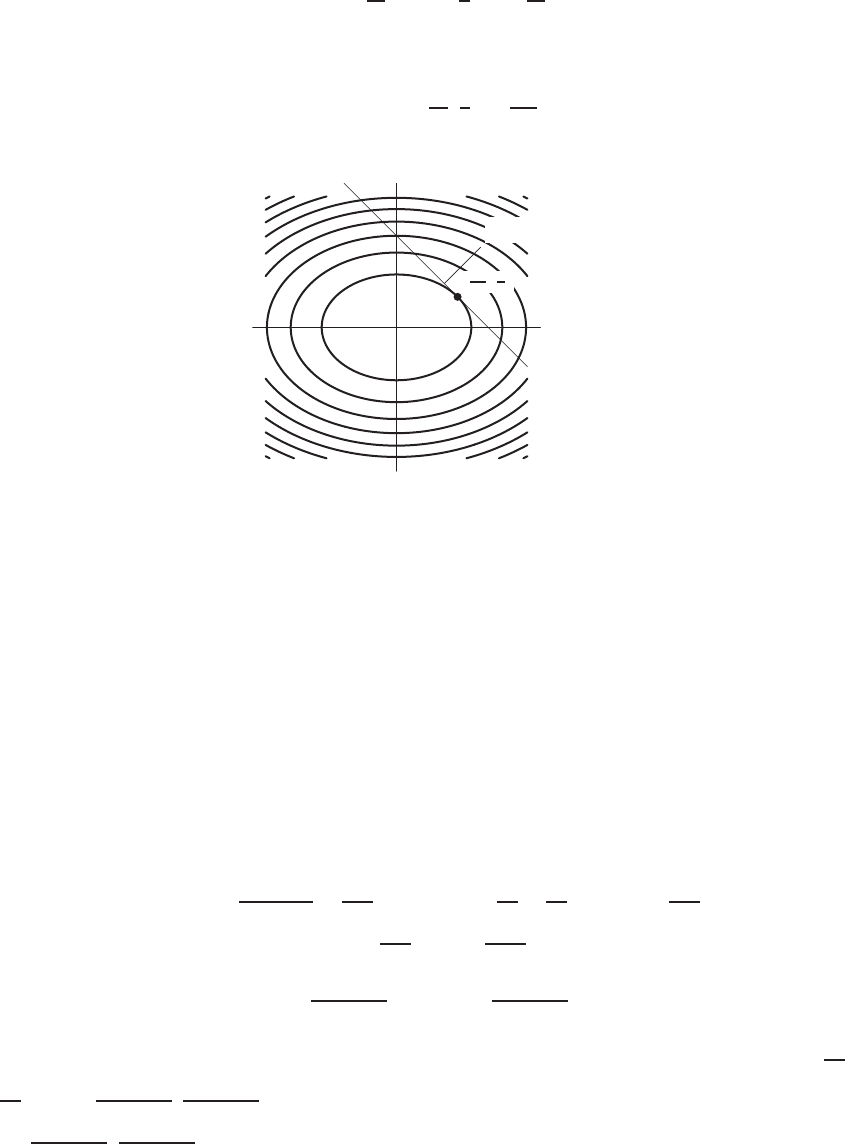
SOLUTIONS to Review Problems for Chapter Fifteen 1453
We have
x=2c
3y=c
3λ=4c
3,
so there is a critical point at (2c/3, c/3). Since moving away from the origin increases values of fin Figure 15.44,
we see that fhas a minimum on the constraint. The minimum value is
m(c) = f2c
3,c
3=2c2
3.
✠
Constraint
x+y=c
(2c
3,c
3)
x
y
Figure 15.44
(b) Calculations in part (a) showed that λ= 4c/3.
(c) The multiplier λis the rate of change of m(c)as cincreases and the constraint moves: that is, λ=m′(c).
36. We are comparing the maxima of f(x, y)subject to the two different constraints g(x, y) = 240 and g(x, y) = 242. As c
changes in the constraint g(x, y) = c, we have
Change in maximum of f≈λ×Change in c= 20 ·2 = 40.
Since the maximum with c= 240 is 6300, we have
Maximum of fconstrained by g(x, y) = 242 ≈6300 + 40 = 6340.
37. Constraint is G=P1x+P2y−K= 0.
Since ∇Q=λ∇G, we have
caxa−1yb=λP1and cbxayb−1=λP2.
Dividing the two equations yields caxa−1yb
cbxayb−1=λP1
λP2
, or simplifying, ay
bx =P1
P2
. Hence, y=bP1
aP2
x.
Substitute into the constraint to obtain P1x+P2
bP1
aP2
x=P1a+b
ax=K, giving
x=aK
(a+b)P1
and y=bK
(a+b)P2
.
We now check that this is indeed the maximization point. Since x, y ≥0, possible maximization points are (0,K
P2
),
(K
P1
,0), and (aK
(a+b)P1
,bK
(a+b)P2
). Since Q= 0 for the first two points and Qis positive for the last point, it follows
that (aK
(a+b)P1
,bK
(a+b)P2
)gives the maximal value.

1454 Chapter Fifteen /SOLUTIONS
38. (a) To be producing the maximum quantity Qunder the cost constraint given, the firm should be using Kand Lvalues
given by
∂Q
∂K = 0.6aK−0.4L0.4= 20λ
∂Q
∂L = 0.4aK0.6L−0.6= 10λ
20K+ 10L= 150.
Hence 0.6aK−0.4L0.4
0.4aK0.6L−0.6= 1.5L
K=20λ
10λ= 2, so L=4
3K. Substituting in 20K+ 10L= 150, we obtain
20K+ 10 4
3K= 150. Then K=9
2and L= 6, so capital should be reduced by 1
2unit, and labor should be
increased by 1 unit.
(b) New production
Old production =a4.50.660.4
a50.650.4≈1.01, so tell the board of directors, “Reducing the quantity of capital by 1/2unit
and increasing the quantity of labor by 1 unit will increase production by 1% while holding costs to $150.”
39. (a) Points A, B, C, D, E; that is, where a level curve of fand the constraint curve are parallel.
(b) Point Fsince the value of fis greatest at this point.
(c) Point Dhas the greatest fvalue of the points A, B, C, D, E.
9
10
11
12
13
❘
g=c
A
B
C
D
E
F
40. We want to minimize the function h(x, y)subject to the constraint that
g(x, y) = x2+y2= 1,0002= 1,000,000.
Using the method of Lagrange multipliers, we obtain the following system of equations:
hx=−10x+ 4y
10,000 = 2λx,
hy=−4x+ 4y
10,000 = 2λy,
x2+y2= 1,000,000.
Multiplying the first equation by yand the second by xwe get
−y(10x+ 4y)
10,000 =−x(4x+ 4y)
10,000 .
Hence:
2y2+ 3xy −2x2= (2y−x)(y+ 2x) = 0,
and so the climber either moves along the line x= 2yor y=−2x.

SOLUTIONS to Review Problems for Chapter Fifteen 1455
We must now choose one of these lines and the direction along that line which will lead to the point of minimum
height on the circle. To do this we find the points of intersection of these lines with the circle x2+y2= 1,000,000,
compute the corresponding heights, and then select the minimum point.
If x= 2y, the third equation gives
5y2= 1,0002,
so that y=±1,000/√5≈ ±447.21 and x=±894.43. The corresponding height is h(±894.43,±447.21) = 2400 m.
If y=−2x, we find that x=±447.21 and y=∓894.43. The corresponding height is h(±447.21,∓894.43) =
2900 m.Therefore, she should travel along the line x= 2y, in either of the two possible directions.
41. The objective function is
f(x, y, z) = p(x−a)2+ (y−b)2+ (z−c)2,
and the constraint is
g(x, y, z) = Ax +By +Cz +D= 0.
Partial derivatives of fand gare
fx=
1
2·2·(x−a)
f(x, y, z)=x−a
f(x, y, z),
fy=
1
2·2·(y−b)
f(x, y, z)=y−b
f(x, y, z),
fz=
1
2·2·(z−c)
f(x, y, z)=z−c
f(x, y, z),
gx=A, gy=B, and gz=C.
Using Lagrange multipliers, we need to solve the equations
grad f=λgrad g
where grad f=fx
~
i+fy~
j+fz~
kand grad g=gx
~
i+gy~
j+gz~
k. This gives a system of equations:
x−a
f(x, y, z)=λA
y−b
f(x, y, z)=λB
z−c
f(x, y, z)=λC
Ax +By +Cz +D= 0.
Now x−a
A=y−b
B=z−c
C=λf(x, y, z)gives
x=A
B(y−b) + a,
z=C
B(y−b) + c,
Substitute into the constraint,
AA
B(y−b) + a+By +CC
B(y−b) + c+D= 0,
A2
B+B+C2
By=A2
Bb−Aa +C2
Bb−Cc −D.
Hence
y=(A2+C2)b−B(Aa +Cc +D)
A2+B2+C2,
y−b=−B(Aa +Bb +Cc +D)
A2+B2+C2

1456 Chapter Fifteen /SOLUTIONS
x−a=A
B(y−b)
=−A(Aa +Bb +Cc +D)
A2+B2+C2
z−c=C
B(y−b)
=−C(Aa +Bb +Cc +D)
A2+B2+C2
Thus the minimum f(x, y, z)is
f(x, y, z) = p(x−a)2+ (y−b)2+ (z−c)2
=−A(Aa +Bb +Cc +D)
A2+B2+C22
+−B(Aa +Bb +Cc +D)
A2+B2+C22
+−C(Aa +Bb +Cc +D)
A2+B2+C221/2
=|Aa+Bb +Cc +D|
√A2+B2+C2.
The geometric meaning is finding the shortest distance from a point (a, b, c)to the plane Ax +By +Cz +D= 0.
42. We first express the revenue Rin terms of the prices p1and p2:
R(p1, p2) = p1q1+p2q2
=p1(517 −3.5p1+ 0.8p2) + p2(770 −4.4p2+ 1.4p1)
= 517p1−3.5p2
1+ 770p2−4.4p2
2+ 2.2p1p2.
At a local maximum we have grad R= 0, and so:
∂R
∂p1
= 517 −7p1+ 2.2p2= 0,
∂R
∂p2
= 770 −8.8p2+ 2.2p1= 0.
Solving these equations, we find that
p1= 110 and p2= 115.
To see whether or not we have a found a local maximum, we compute the second-order partial derivatives:
∂2R
∂p2
1
=−7,∂2R
∂p2
2
=−8.8,∂2R
∂p1∂p2
= 2.2.
Therefore,
D=∂2R
∂p2
1
∂2R
∂p2
2−∂2R
∂p1∂p2
= (−7)(−8.8) −(2.2)2= 56.76,
and so we have found a local maximum point. The graph of P(p1, p2)has the shape of an upside down paraboloid. Since
Pis quadratic in q1and q2,(110,115) is a global maximum point.
43. We want to minimize cost C= 100L+ 200Ksubject to Q= 900L1/2K2/3= 36000. Using Lagrange multipliers, we
get
∇Q=450L−1/2K2/3~
i+600L1/2K−1/3~
j.
∇C= 100
~
i+ 200~
j
∇C=λ∇Qgives
100 = λ450L−1/2K2/3and 200 = λ600L1/2K−1/3.
Since λ6= 0 this gives
450L−1/2K2/3= 300L1/2K−1/3.
Solving, we get L= (3/2)K. Substituting into Q= 36,000 gives
900 3
2K1/2
K2/3= 36,000.
Solving yields K=h40 ·2
31/2i6/7
≈19.85, so L≈3
2(19.85) = 29.78. We can thus calculate cost using K= 20
and L= 30 which gives C= $7,000.

SOLUTIONS to Review Problems for Chapter Fifteen 1457
44. We wish to minimize the objective function
C(x, y, z) = 20x+ 10y+ 5z
subject to the budget constraint
Q(x, y, z) = 20x1/2y1/4z2/5= 1,200.
Therefore, we solve the equations grad C=λgrad Qand Q= 1,200:
20 = 10λx−1/2y1/4z2/5or λ= 2x1/2y−1/4z−2/5,
10 = 5λx1/2y−3/4z2/5,or λ= 2x−1/2y3/4z−2/5,
5 = 8λx1/2y1/4z−3/5,or λ= 0.625x−1/2y−1/4z3/5,
20x1/2y1/4z2/5= 1,200.
The first and second equations imply that
x=y,
while the second and third equations imply that
3.2y=z.
Substituting for xand zin the constraint equation gives
20y1/2y1/4(3.2y)2/5= 1200
y≈23.47,
and so
x≈23.47 and z≈75.1.
45. Cost of production, C, is given by C=p1W+p2K=b. At the optimal point, ∇q=λ∇C.
Since ∇q=c(1−a)W−aKa~
i+caW 1−aKa−1~
jand ∇C=p1
~
i+p2~
j , we get
c(1 −a)W−aKa=λp1and caW 1−aKa−1=λp2.
Now, marginal productivity of labor is given by ∂q
∂W =c(1 −a)W−aKaand marginal productivity of capital is given by
∂q
∂K =caW 1−aKa−1, so their ratio is given by
∂q
∂W
∂q
∂K
=c(1 −a)W−aKa
caW 1−aKa−1=λp1
λp2
=p1
p2
which is the ratio of the cost of one unit of labor to the cost of one unit of capital.
46. (a) The objective function is the energy loss, i2
1R1+i2
2R2, and the constraint is i1+i2=I, where Iis a constant. The
Lagrangian function is
L(i1, i2, λ) = i2
1R1+i2
2R2−λ(i1+i2−I).
We look for solutions to the system of equations we get from grad L=~
0:
∂L
∂i1
= 2i1R1−λ= 0
∂L
∂i2
= 2i2R2−λ= 0
∂L
∂λ =−(i1+i2−I) = 0.
Combining ∂L
∂i1−∂L
∂i2
= 2(i1R1−i2R2) = 0 with ∂L
∂λ = 0 gives the two equation system
i1R1−i2R2= 0
i1+i2=I.
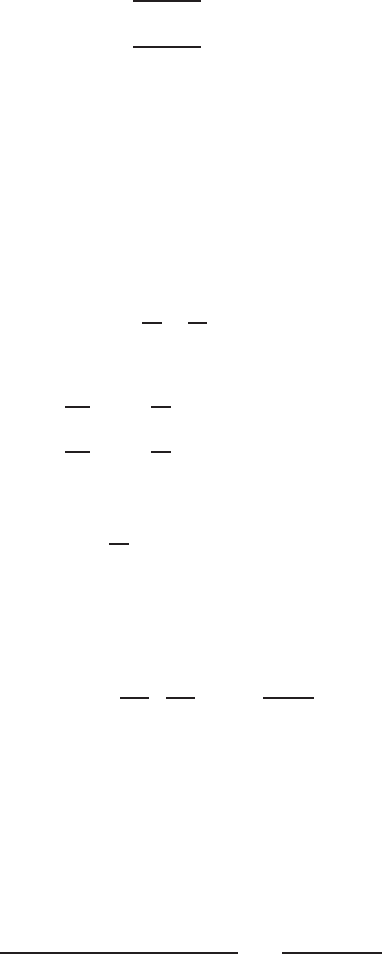
1458 Chapter Fifteen /SOLUTIONS
Substituting i2=I−i1into the first equation leads to
i1=R2
R1+R2
I
i2=R1
R1+R2
I.
(b) Ohm’s Law states that across a resistor
Voltage =Current ·Resistance.
Since λ/2 = i1·R1=i2·R2, the Lagrange multiplier λequals twice the voltage across the resistors.
47. Let the sides of the base be xand ycm. Let the height be zcm. Then the volume is given by xyz = 32 and the surface
area, S, is given by
S=xy + 2xz + 2yz.
Substituting z= 32/(xy)gives
S=xy +64
y+64
x.
At a critical point
∂S
∂x =y−64
x2= 0
∂S
∂y =x−64
y2= 0.
The symmetry of the equations tells us that x=yand
x−64
x2= 0
x3= 64
x= 4 cm.
Thus the only critical point is x=y= 4 cm and z= 32/(4 ·4) = 2 cm. At the critical point
D=SxxSyy −(Sxy )2=128
x3·128
y3−12=(128)2
x3y3−1.
Since D > 0and Sxx >0at this critical point, the critical point x=y= 4, z = 2 is a local minimum. Since S→ ∞ as
x, y → ∞, the local minimum is a global minimum.
48. The point Pis the solution to the constraint optimization problem of maximizing the square of the distance function.
D=x2+y2+x2
subject to the constraint
g(x, y, z) = f(x, y)−z= 0.
(We take the square of the distance between the point (x, y, z)and the origin, which is
Distance =p(x−0)2+ (y−0)2+ (z−0)2=px2+y2+z2,
because it makes the calculations easier.) Therefore, at point P, we have ∇D=λ∇g, so ∇Dis parallel to ∇g.
We know that ∇gis perpendicular to the surface g(x, y, z) = 0; that is, perpendicular to the surface z=f(x, y).
Also
∇D= 2x
~
i+ 2y~
j+ 2z~
k .
At point P, whose position vector is ~p =a
~
i+b~
j+c~
k, we have
∇D= 2(a
~
i+b~
j+c~
k) = 2~p .
Thus, ~p is parallel to ∇Dand therefore ~p is also perpendicular to the surface.

SOLUTIONS to Review Problems for Chapter Fifteen 1459
49. You should try to anticipate your opponent’s choice. After you choose a value λ, your opponent will use calculus to
find the point (x, y)that maximizes the function f(x, y) = 10 −x2−y2−2x−λ(2x+ 2y). At that point, we have
fx=−2x−2−2λ= 0 and fy=−2y−2λ= 0, so your opponent will choose x=−1−λand y=−λ. This gives a
value L(−1−λ, −λ, λ) = 10 −(−1−λ)2−(−λ)2−2(−1−λ)−λ(2(−1−λ) + 2(−λ)) = 11+2λ+2λ2which you
want to make as small as possible. You should choose λto minimize the function h(λ) = 11 + 2λ+ 2λ2. You choose λ
so that h′(λ) = 2 + 4λ= 0, or λ=−1/2. Your opponent then chooses (x, y) = (−1−λ, −λ) = (−1/2,1/2), giving
a final score of L(−1/2,1/2,−1/2) = 10.5. No choice of λthat you can make can force the value of Lbelow 10.5. But
your choice of λ=−1/2makes it impossible for your opponent to force the value of Labove 10.5.
50. The wetted perimeter of the trapezoid is given by the sum of the lengths of the three walls, so
p=w+2d
sin θ
We want to minimize psubject to the constraint that the area is fixed at 50 m2. A trapezoid of height hand with parallel
sides of lengths b1and b2has
A=Area =h(b1+b2)
2.
In this case, dcorresponds to hand b1corresponds to w. The b2term corresponds to the width of the exposed surface of
the canal. We find that b2=w+ (2d)/(tan θ). Substituting into our original equation for the area along with the fact that
the area is fixed at 50 m2, we arrive at the formula:
Area =d
2w+w+2d
tan θ=dw+d
tan θ= 50
We now solve the constraint equation for one of the variables; we will choose wto give
w=50
d−d
tan θ.
Substituting into the expression for pgives
p=w+2d
sin θ=50
d−d
tan θ+2d
sin θ.
We now take partial derivatives:
∂p
∂d =−50
d2−1
tan θ+2
sin θ
∂p
∂θ =d
tan2θ·1
cos2θ−2d
sin2θ·cos θ
From ∂p/∂θ = 0, we get
d·cos2θ
sin2θ·1
cos2θ=2d
sin2θ·cos θ.
Since sin θ6= 0 and cos θ6= 0, canceling gives
1 = 2 cos θ
so
cos θ=1
2.
Since 0< θ < π
2,we get θ=π
3.
Substituting into the equation ∂p/∂d = 0 and solving for dgives:
−50
d2−1
√3+2
√3/2= 0
which leads to
d=r50
√3≈5.37m.
Then
w=50
d−d
tan θ≈50
5.37 −5.37
√3≈6.21 m.
When θ=π/3,w≈6.21 m and d≈5.37 m, we have p≈18.61 m.
Since there is only one critical point, and since pincreases without limit as dor θshrink to zero, the critical point
must give the global minimum for p.
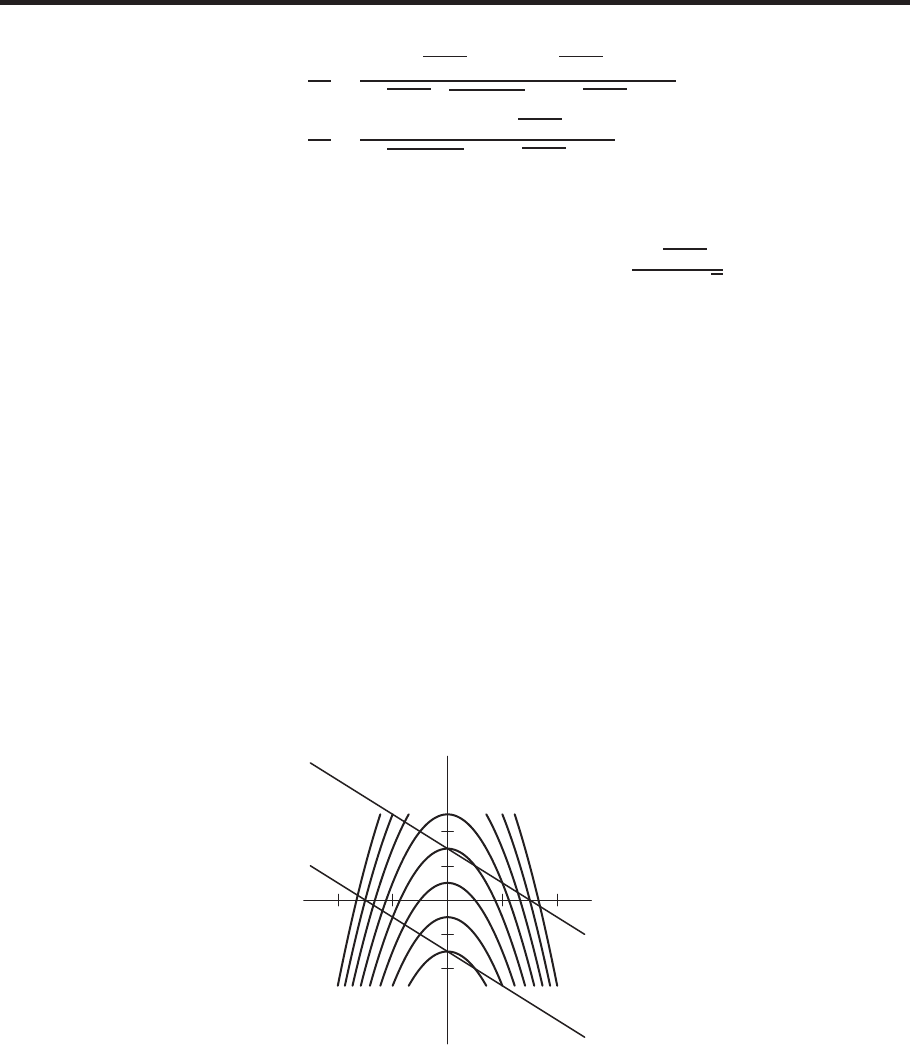
1460 Chapter Fifteen /SOLUTIONS
CAS Challenge Problems
51. (a) The partial derivatives of fare
∂f
∂x =√a+x+−1 + √a+xy
2√a+x√a+x+y1 + √a+x+y2
∂f
∂y =1−2a−2x+√a+x−y
2√a+x+y1 + √a+x+y2
Solving ∂f /∂x = 0,∂f/∂y = 0, we get x= 1/4−a, y = 1. The discriminant at this point is D=−16/625.
Thus, by the second derivative test, the point is a saddle point.
(b) The ycoordinate of the critical points stays the same and the xcoordinate is aunits to the left of its position when
a= 0. The type is always a saddle point. This is because fis obtained from √x+y
1 + y+√xby substituting x+afor
x, so that the graph is shifted aunits in the negative x-direction but its shape remains the same.
52. (a) We have grad f= 2x
~
i+~
jand grad g= (2x+ 2y)
~
i+ (2x+ 2y)~
j. So the equations to be solved in the method
of Lagrange multipliers are
2x=λ(2x+ 2y)
1 = λ(2x+ 2y)
x2+ 2xy +y2−9 = 0
Solving these with a CAS, we get two solutions:
x= 1/2, y =−7/2, λ =−1/6,or x= 1/2, y = 5/2, λ = 1/6
Student A reasons that since f(1/2,−7/2) = −13/4and f(1/2,5/2) = 11/4, the (global) maximum and
minimum values are 11/4 and 13/4, respectively. Student B graphs the constraint curve g= 0 and a contour diagram
of f. The constraint curve turns out to be two straight lines, since the constraint x2+ 2xy +y2−9 = 0, which can
be rewritten as (x+y)2= 9, or x+y=±3. The value of fgoes to infinity on each of these straight lines. On the
line y=−x+ 3,f(x, y) = x2+y=x2−x+ 3, and on the line y=−x−3,f(x, y) = x2+y=x2−x−3.
Thus Student B is correct. The points Student A found are actually local maximum and local minimum values, not
global. Since the constraint is not bounded, there is no guarantee that there is a local maximum or minimum. See
Figure 15.45.
−4−2 2 4
−4
−2
2
4
g
g
x
y
Figure 15.45
: Contours of fand two straight
lines giving constraint g= 0
53. (a) We have grad f= 3
~
i+ 2~
jand grad g= (4x−4y)
~
i+ (−4x+ 10y)~
j, so the Lagrange multiplier equations are
3 = λ(4x−4y)
2 = λ(−4x+ 10y)
2x2−4xy + 5y2= 20

PROJECTS FOR CHAPTER FIFTEEN 1461
Solving these with a CAS we get λ=−0.4005, x =−3.9532, y =−2.0806 and λ= 0.4005, x = 3.9532, y =
2.0806. We have f(−3.9532,−2.0806) = −11.0208, and f(3,9532,2.0806) = 21.0208. The constraint equation
is 2x2−4xy + 5y2= 20, or, completing the square, 2(x−y)2+ 3y2= 20. This has the shape of a skewed ellipse,
so the constraint curve is bounded, and therefore the local maximum is a global maximum. Thus the maximum value
is 21.0208.
(b) The maximum value on g= 20.5is ≈21.0208 + 0.5(0.4005) = 21.2211. The maximum value on g= 20.2is
≈21.0208 + 0.2(0.4005) = 21.1008.
(c) We use the same commands in the CAS from part (a), with 20 replaced by 20.5 and 20.2, and get the maximum
values 21.2198 for g= 20.5and 21.1007 for g= 20.2. These agree with the approximations we found in part (b) to
2 decimal places.
PROJECTS FOR CHAPTER FIFTEEN
1. (a) The price of p/q units of Bat unit price qis p/q ·q=p, the same as the price of one unit of A. On a fixed
budget, p/q units of Bcan substitute for one unit of A. Thus the ERS is p/q.
(b) The TRS measures the rate at which yincreases with respect to xas a point (x, y)slides in the direction
of decreasing xalong a fixed contour f(x, y) = Qof the production function. Thus TRS =−dy/dx, the
negative of the slope of the contour. On the contour the differential df =fxdx +fydy is zero because f
has constant value there. Thus fxdx +fydy = 0 which gives TRS =−dy/dx =fx/fy.
(c) We want to maximize the production function f(x, y)subject to a budget constraint px +qy =C, where
Cis the fixed budget. At a maximum we have grad f=λgrad gor
fx=λgx
fy=λgy.
Dividing the first equation by the second gives fx/fy=gx/gyor TRS =ERS.
(d) We are asked to minimize the cost function g(x, y)subject to a production constraint f(x, y) = Q, where
Qis the fixed quantity to be produced. At a minimum we have grad g=λgrad for
gx=λfx
gy=λfy.
Dividing the first equation by the second gives gx/gy=fx/fyor ERS =TRS.
2.
(xi, b +mxi)
(xi, yi)(x1, b +mx1)
(x1, y1)
y=b+mx
Figure 15.46
(a) Points which are directly above or below each other share the same xcoordinate, therefore, the point on
the least squares line which is directly above or below the point in question will have xcoordinate xiand
from the formula for the least squares line, it will have ycoordinate b+mxi. (See Figure 14.1.)
(b) The general distance formula in two dimensions is d=p(x2−x1)2+ (y2−y1)2, so d2= (x2−x1)2+
(y2−y1)2. Since the xcoordinates are identical for the two points in question, the first term in the square
root is zero. This yields d2= (yi−(b+mxi))2.
(c) In both cases we use the chain rule and our knowledge of summations to show the relationship.
∂f
∂b =∂
∂b n
X
i=1
(yi−(b+mxi))2!=
n
X
i=1
∂
∂b(yi−(b+mxi))2
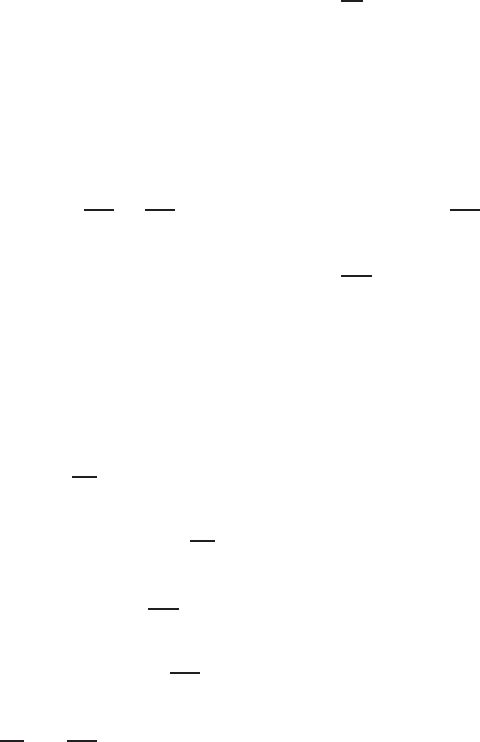
1462 Chapter Fifteen /SOLUTIONS
=
n
X
i=1
2(yi−(b+mxi)) ·∂
∂b(yi−(b+mxi))
=
n
X
i=1
2(yi−(b+mxi)) ·(−1)
=−2
n
X
i=1
(yi−(b+mxi))
∂f
∂m =∂
∂m n
X
i=1
(yi−(b+mxi))2!=
n
X
i=1
∂
∂m(yi−(b+mxi))2
=
n
X
i=1
2(yi−(b+mxi)) ·∂
∂m(yi−(b+mxi))
=
n
X
i=1
2(yi−(b+mxi)) ·(−xi)
=−2
n
X
i=1
(yi−(b+mxi)) ·xi
(d) We can separate ∂f
∂b into three sums as shown:
∂f
∂b =−2 n
X
i=1
yi−b
n
X
i=1
1−m
n
X
i=1
xi!
Similarly we can separate ∂f
∂m after multiplying through by xi:
∂f
∂m =−2 n
X
i=1
yixi−b
n
X
i=1
xi−m
n
X
i=1
xi2!
Setting ∂f
∂b and ∂f
∂m equal to zero we have:
bn +m
n
X
i=1
xi=
n
X
i=1
yi
b
n
X
i=1
xi+m
n
X
i=1
x2
i=
n
X
i=1
xiyi
(e) To solve this pair of linear equations, we multiply the first equation by Pn
i=1 x2
i, multiply the second one
by Pn
i=1 xi, and subtract; we get
bn
n
X
i=1
x2
i−b(
n
X
i=1
xi)2=
n
X
i=1
yi
n
X
i=1
x2
i−
n
X
i=1
xiyi
n
X
i=1
xi,
So,
b= n
X
i=1
x2
i
n
X
i=1
yi−
n
X
i=1
xi
n
X
i=1
xiyi!/
n
n
X
i=1
x2
i− n
X
i=1
xi!2
Similarly,
m= n
n
X
i=1
xiyi−
n
X
i=1
xi
n
X
i=1
yi!/
n
n
X
i=1
x2
i− n
X
i=1
xi!2
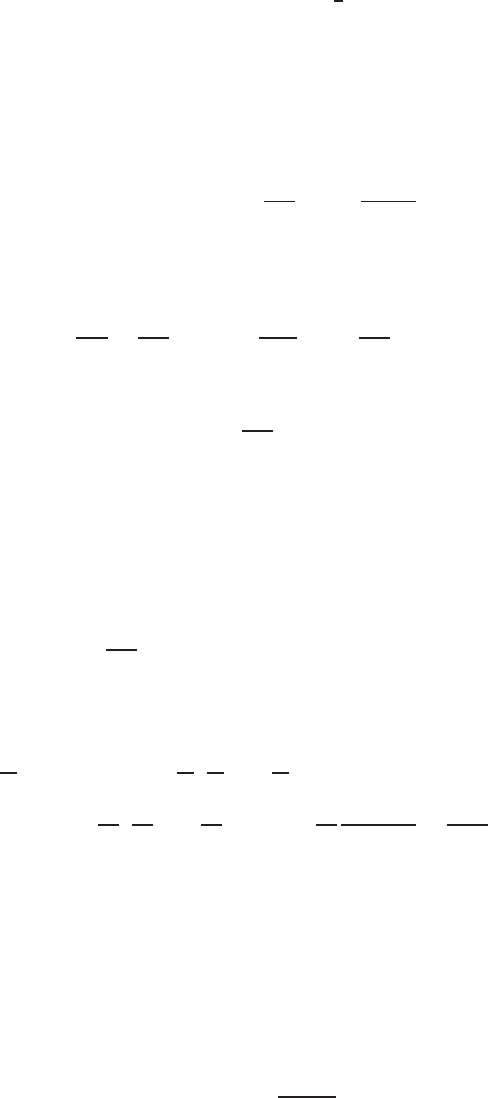
PROJECTS FOR CHAPTER FIFTEEN 1463
(f) Applying the formulas to the given data, we have b=−1
3,m= 1 which gives y=−(1/3) + x, in
agreement with the example.
3. (a) If p=e−xwhere x→∞then p→0with p > 0and
lim
p→0
p>0
(pln p) = lim
x→∞ (−xe−x) = 0,
since the exponential decreases faster than any power of x. Alternatively, use l’Hopital’s rule:
lim
p→0
p>0
(pln p) = lim
p→0
p>0
ln p
1/p = lim
p→0
p>0
1/p
−1/p2= 0
(b) We apply the method of Lagrange multipliers to find the critical points of S(p1,···, p30). The constraint
function is g(p1,···, p30) = p1+· ·· +p30. We have
∂S
∂pj
=∂
∂pj −
30
X
i=1
pi
ln pi
ln 2 !=−1
ln 2(ln pj+ 1),
therefore
grad S=−1
ln 2
30
X
j=1
(ln pj+ 1) ~
kj
where ~
k1,···,~
k30 are the unit vectors corresponding 30 independent directions of the pj-axes. Also,
grad g=
30
X
j=1
~
kj
so the condition grad S=λgrad gbecomes
−1
ln 2(ln pj+ 1) = λ, for i= 1,···,30.
Thus,
ln pj=−λln 2 −1
and, in particular, all the pjsmust be equal. Since the pjshave to satisfy the constraint g(p1,···, p30) = 1,
we see that pj=1
30 and that the point (1
30 ,1
30 ,···,1
30 )is the only critical point of S. We have
S1
30,1
30,···,1
30=−30 ·1
30
(−ln 30)
ln 2 =ln 30
ln 2 .
We will not prove that this is indeed the maximum value of S(this requires a higher-dimensional analogue
of the second derivative test). Since in part (c) we show that the minimum value of Sis 0, the critical point
we have found here is not a global minimum; the maximum of Shas to be attained somewhere and it is
reasonable to believe that it is attained at the unique critical point. The maximum entropy corresponds to
maximum uncertainty in the outcome of the competition.
(c) We already know that S≥0. However, Scan be zero: For example, if p1= 1 and p2=··· =p30 = 0,
we have S(1,0,···,0) = 0. Therefore the minimum value of Sis 0. Now we determine all the values of
pisfor which S(p1,···, p30) = 0. The condition
S=−
30
X
i=1
piln pi
2= 0
together with the restrictions −ln pi≥0shows that, for Sto vanish, each individual term in the above
sum has to vanish. This means piln pi= 0 for all i= 1,···,30, that is, pi= 0 or pi= 1 for i= 1,···,30.
Since P30
i=1 pi= 1, only one of the pisis 1 whereas the other 29 are 0. This corresponds to the case where
one of the teams is certain to win, that is, there is no uncertainty. The result can be interpreted by saying
that zero entropy implies zero uncertainty.
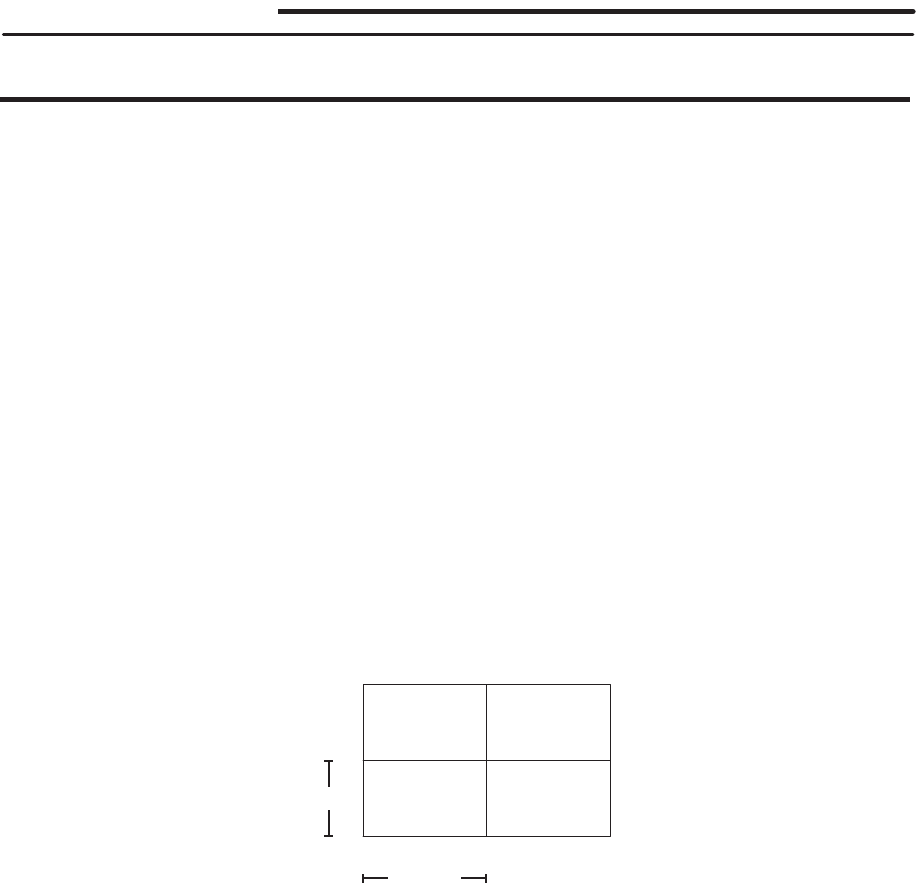
16.1 SOLUTIONS 1465
CHAPTER SIXTEEN
Solutions for Section 16.1
Exercises
1. Using ∆x= 3 and ∆y= 0.5:
Lower estimate = (4 + 5 + 3 + 4)∆x∆y= 16 ·3·0.5 = 24,
Upper estimate = (7 + 10 + 5 + 7)∆x∆y= 29 ·3·0.5 = 43.5.
2. Mark the values of the function on the plane, as shown in Figure 16.1, so that you can guess respectively at the smallest
and largest values the function takes on each small rectangle.
Lower sum =Xf(xi,yi)∆x∆y
= 4∆x∆y+ 6∆x∆y+ 3∆x∆y+ 4∆x∆y
= 17∆x∆y
= 17(0.1)(0.2) = 0.34.
Upper sum =Xf(xi,yi)∆x∆y
= 7∆x∆y+ 10∆x∆y+ 6∆x∆y+ 8∆x∆y
= 31∆x∆y
= 31(0.1)(0.2) = 0.62.
1.0 1.1 1.2
2.0
2.2
2.4
←x
↓
y
5
4
3
7
6
5
10
8
4
✲✛ ∆x= 0.1
✻
❄
∆y= 0.2
Figure 16.1
3. There are nine squares. Using the largest value of gin each square for the overestimate and the smallest value for the
underestimate, we have
Overestimate ≈(2 + 2.8 + 3.5 + 2.8 + 4 + 4.9 + 3.4 + 4.9 + 6)∆x∆y= 34.3·2·2 = 137.2.
Underestimate ≈(0 + 0.8 + 0.9 + 0.8 + 2 + 2.8 + 0.9 + 2.8 + 4)∆x∆y= 15 ·2·2 = 60.

1466 Chapter Sixteen /SOLUTIONS
4. In the subrectangle in the top left of the figure given, it appears that f(x, y)has a maximum value of about 9. In the
subrectangle in the top middle, f(x, y)has a maximum value of 10. Continuing in this way, and multiplying by ∆xand
∆y, we have
Overestimate = (9 + 10 + 12 + 7 + 8 + 10 + 5 + 7 + 8) ·10 ·5 = 3800.
Similarly, we find
Underestimate = (7 + 7 + 8 + 4 + 5 + 7 + 1 + 3 + 6) ·10 ·5 = 2400.
Thus, we expect that
2400 ≤ZR
f(x, y)dA ≤3800.
5. Let Rbe the rectangle, and let f(x, y)be the population density at the point (x, y)in the rectangle. The population is
given by RRf(x, y)dA. We approximate the integral with a 6 term Riemann sum using six 1km ×1km squares in the
region. To make a Riemann sum, choose a population density value at one point of each of the squares. For accuracy, we
choose the midpoint of each square, but other choices are possible.
The densities at the midpoints can only be estimated from the contour diagram, and different people may make
different judgments. The value at the point (2.5,1.5) is particularly difficult, because the diagram tells us only that the
density is between 0 and 200. The table gives one reasonable set of values.
y
x
0.5 1.5 2.5
1.5 500 450 100
0.5 650 200 400
Each square has area 1km2. We have
ZR
f(x, y)dA ≈500 ·1 + 450 ·1 + 100 ·1 + 650 ·1 + 200 ·1 + 400 ·1 = 2300 people.
The population is approximately 2300 people.
Problems
6. The function being integrated is f(x, y) = 1, which is positive everywhere. Thus, its integral over any region is positive.
7. The function being integrated is f(x, y) = 5x. Since x > 0in R,fis positive in Rand thus the integral is positive.
8. The function being integrated is f(x, y) = 5x, which is an odd function in x. Since Bis symmetric with respect to x, the
contributions to the integral cancel out, as f(x, y) = −f(−x, y). Thus, the integral is zero.
9. The function being integrated, f(x, y) = y3+y5, is an odd function in ywhile Dis symmetric with respect to y. Then,
by symmetry, the positive and negative contributions of fwill cancel out and thus its integral is zero.
10. In a region such as Bin which y < 0, the quantity y3+y5is less than zero. Thus, its integral is negative.
11. The function being integrated, f(x, y) = y−y3, is an odd function in ywhile Dis symmetric with respect to y. By
symmetry, the integral is zero.
12. The function being integrated, f(x, y) = y−y3is always negative in the region Bsince in that region −1< y < 0and
|y3|<|y|. Thus, the integral is negative.
13. The total area of the square Ris (1.5)(1.5) = 2.25. See Figure 16.2. On a disk of radius ≈0.5the function has a value of 3
or more, giving a total contribution to the integral of at least (3)·(π·0.52)≈2.3. On less than half of the rest of the square
the function has a value between −2and 0, giving a contribution to the integral of between (1/2·2.25)(−2) = −2.25 and
0. Since the positive contribution to the integral is therefore greater in magnitude than the negative contribution, RRfdA
is positive.
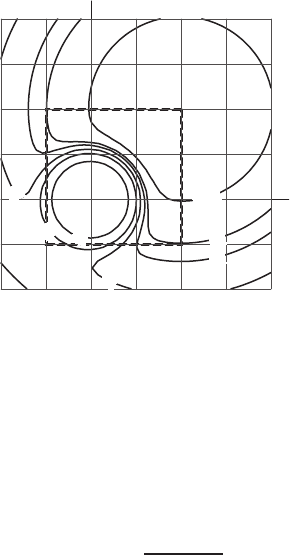
16.1 SOLUTIONS 1467
−1.0−0.5 0 0.5 1.0 1.5 2.0
−1.0
−0.5
0
0.5
1.0
1.5
2.0
x
y
−1
0
1
2
2
3
4
Figure 16.2
14. We use four subrectangles to find an overestimate and underestimate of the integral:
Overestimate = (15 + 9 + 9 + 5)(4)(3) = 456,
Underestimate = (5 + 2 + 3 + 1)(4)(3) = 132.
A better estimate of the integral is the average of the two:
ZR
f(x, y)dA ≈456 + 132
2= 294.
The units of the integral are milligrams, and the integral represents the total number of mg of mosquito larvae in this 8
meter by 6 meter section of swamp.
15. Let’s break up the room into 25 sections, each of which is 1 meter by 1 meter and has area ∆A= 1.
We shall begin our sum as an upper estimate starting with the lower left corner of the room and continue across the
bottom and moving upward using the highest temperature, Ti, in each case. So the upper Riemann sum becomes
P25
i=1Ti∆A=T1∆A+T2∆A+T3∆A+·· · +T25∆A
= ∆A(T1+T2+T3+···+T25)
= (1)( 31 +29 + 28 + 27 + 27+
29 +28 + 27 + 27 + 26+
27 +27 + 26 + 26 + 26+
26 +26 + 25 + 25 + 25+
25 +24 + 24 + 24 + 24)
= (1)(659) = 659.
In the same way, the lower Riemann sum is formed by taking the lowest temperature, ti, in each case:
P25
i=1ti∆A=t1∆A+t2∆A+t3∆A+···+t25∆A
= ∆A(t1+t2+t3+··· +t25)
= (1)( 27 +27 + 26 + 26 + 25+
26 +26 + 25 + 25 + 25+
25 +24 + 24 + 24 + 24+
24 +23 + 23 + 23 + 23+
23 +21 + 20 + 21 + 22)
= (1)(602) = 602.
So, averaging the upper and lower sums we get: 630.5.
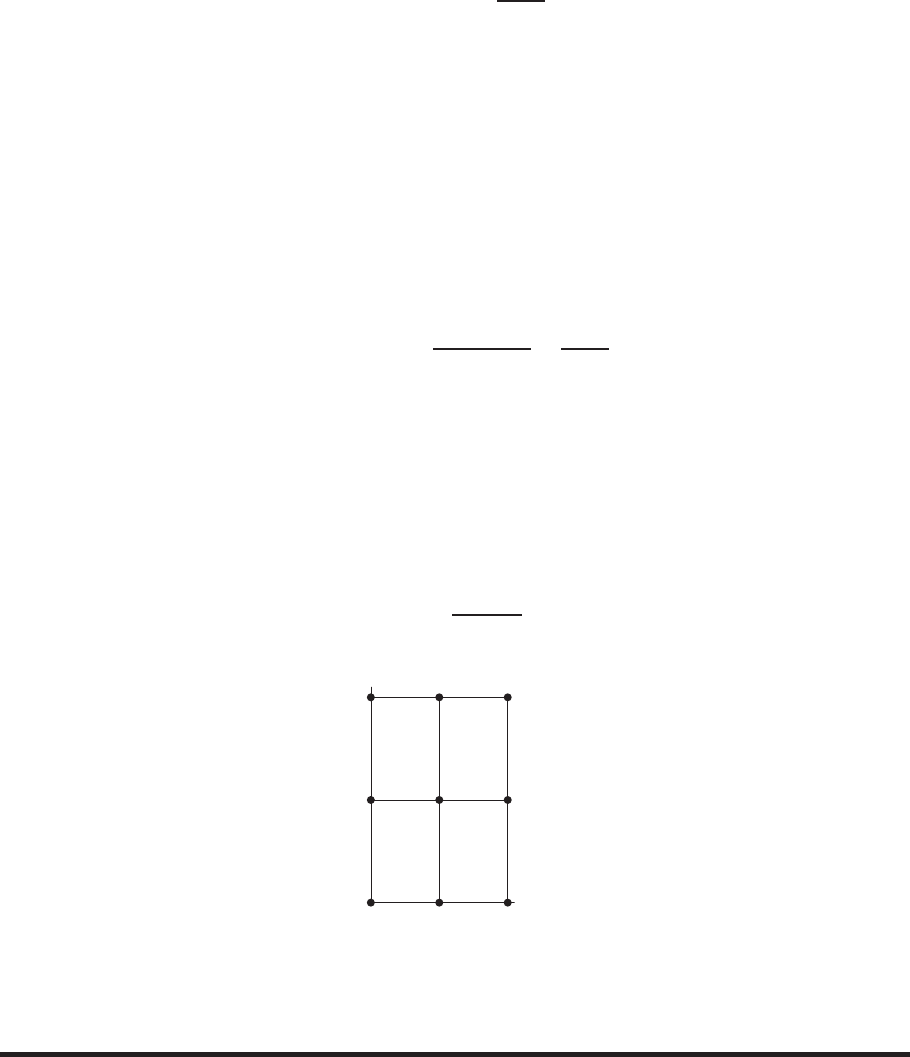
1468 Chapter Sixteen /SOLUTIONS
To compute the average temperature, we divide by the area of the room, giving
Average temperature =630.5
(5)(5) ≈25.2◦C.
Alternatively we can use the temperature at the central point of each section ∆A. Then the sum becomes
P25
i=1 T′
i∆A= ∆AP25
i=1 T′
i
= (1)( 29 +28 + 27 + 26.5 + 26+
27 +27 + 26 + 26 + 25.5+
26 +25.5 + 25 + 25 + 25+
25 +24 + 24 + 24 + 24+
24 +23 + 22 + 22.5 + 23)
= (1)(630) = 630.
Then we get
Average temperature =P25
i=1T′
i∆A
Area =630
(5)(5) ≈25.2◦C.
16. We divide the base region into four subrectangles as shown in Figure 16.3. The height of the object at each point (x, y)
is given by f(x, y) = x+y, we label each corner of the subrectangles with the value of the function at that point. (See
Figure 16.3.) Since Volume =Height ×Length ×Width, and ∆x= 2 and ∆y= 3, we have
Overestimate = (8 + 10 + 5 + 7)(2)(3) = 360,
and
Underestimate = (3 + 5 + 0 + 2)(2)(3) = 60.
We average these to obtain
Volume ≈360 + 60
2= 210.
2 4
3
6
f= 0
f= 2
f= 4
f= 3
f= 5
f= 7
f= 6
f= 8
f= 10
x
y
Figure 16.3
Strengthen Your Understanding
17. This is true only if fis nonnegative everywhere. Integrals can be negative, but volumes never can be negative.
18. The sign of an integral depends on the values of fon the region R. If fis positive everywhere on the region R, then
RRf(x, y)dA is positive.
19. We want the value of fat the lower left-hand corner of each subrectangle to be the largest value in the subrectangle. For
example, let f(x, y)be a linear function with negative slopes, say f(x, y) = 5 −x−y. Let Rbe the square with vertices
(±1,±1).
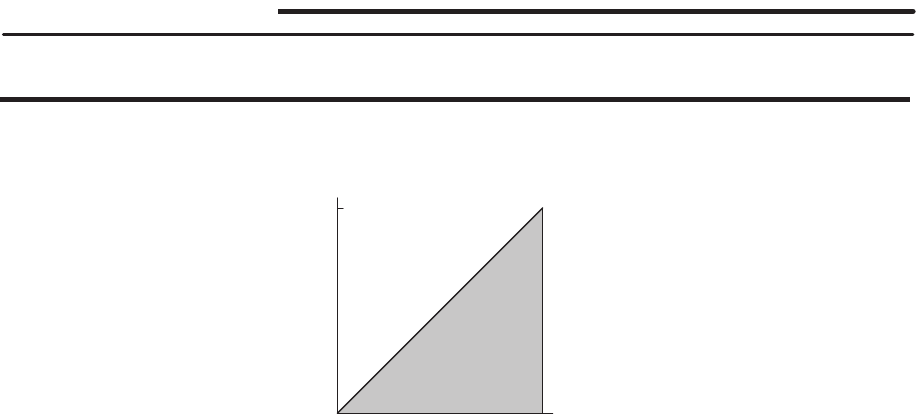
16.2 SOLUTIONS 1469
20. A function whose values are negative everywhere has a negative average value on any region. For example, f(x, y) = −1
has average value −1on the square.
21. False. For example, if f(x, y)<0for all (x, y)in the region R, then RRfdA is negative.
22. True. The double integral is the limit of the sum
Xf(x, y)∆A=Xk∆A=kX∆A
over rectangles that lie inside the region R. As the area ∆A→0, this sum approaches k·Area(R).
23. False. The function f(x, y) = exy is largest at the (1,1) corner of R, so for any (x, y)in Rwe have exy ≤e1·1=e.
Then ZR
exydA = lim
∆A→0Xexy∆A≤lim
∆A→0Xe∆A=elim
∆A→0X∆A=e·Area(R) = e.
So RRexy dA ≤e≈2.7.
24. False. For example, if f= 1, then RR1dA =Area(R) = 6 and RS1dA =Area(S) = 6.
25. True. The double integral is the limit of the sum P∆A→0ρ(x, y)∆A. Each of the terms ρ(x, y)∆Ais an approximation
of the total population inside a small rectangle of area ∆A. Thus the limit of the sum of all of these numbers as ∆A→ ∞
gives the total population of the region R.
26. False. If the graph of fhas equal volumes above and below the xy-plane over the region R, the double integral is zero
without having f(x, y) = 0 everywhere.
27. True. Writing the definition of the integral of g, we have
ZR
gdA = lim
∆A→0Xg(x, y)∆A= lim
∆A→0Xkf (x, y)∆A=klim
∆A→0Xf(x, y)∆A=kZR
f dA.
28. False. As a counterexample, let Rbe a rectangle with area 2and take f(x, y) = g(x, y) = 1.Then RRf·g dA =
RR1dA =Area(R) = 2,but RRf dA =RRg dA =Area(R)·Area(R) = 4.
29. False. There is no reason to expect this to be true, since the behavior of fon one half of Rcan be completely unrelated
to the behavior of fon the other half. As a counterexample, suppose that fis defined so that f(x, y) = 0 for points
(x, y)lying in S, and f(x, y) = 1 for points (x, y)lying in the part of Rthat is not in S. Then RSfdA = 0, since
f= 0 on all of S. To evaluate RRf dA, note that f= 1 on the square S1which is 0≤x≤1,1≤y≤2. Then
RRf dA =RS1f dA =Area(S1) = 1, since f= 0 on S.
30. True. Since all points in the region Rsatisfy x < y, it is true that at every point in R,f(x, y) = x+x < x +y=g(x, y).
Since all of the values of fin Rare less than those of g, the average of the values of fis less than the average of the
values of g.
Solutions for Section 16.2
Exercises
1. See Figure 16.4.
π
πZπ
0Zx
0
ysin x dy dx
x
y
Figure 16.4
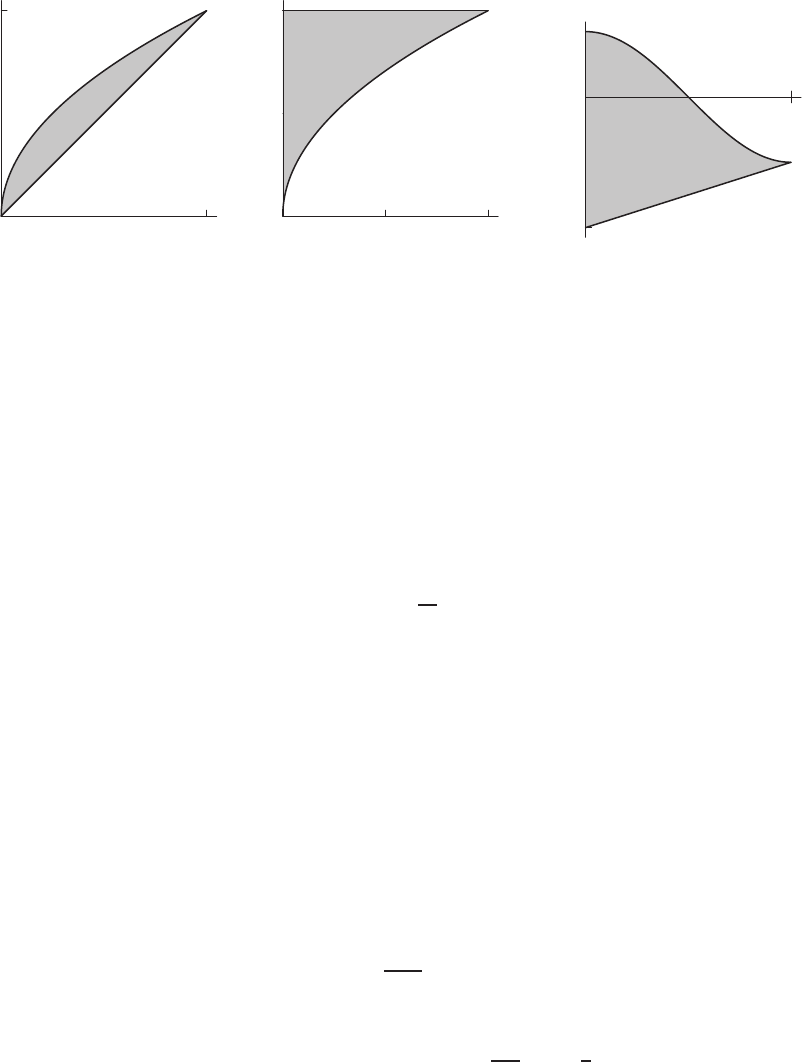
1470 Chapter Sixteen /SOLUTIONS
2. See Figure 16.5.
3. See Figure 16.6.
4. See Figure 16.7.
1
1Z1
0Zy
y2
xy dx dy
x
y
Figure 16.5
2 4
1
2Z2
0Zy2
0
y2x dx dy
x
y
Figure 16.6
1
−2
−1
1Z1
0Zcos πx
x−2
y dy dx
x
y
Figure 16.7
5. We evaluate the inside integral first:
Z4
0
(4x+ 3y)dx = (2x2+ 3yx)
4
0
= 32 + 12y.
Therefore, we have
Z3
0Z4
0
(4x+ 3y)dxdy =Z3
0
(32 + 12y)dy = (32y+ 6y2)
3
0
= 150.
6. We evaluate the inside integral first:
Z3
0
(x2+y2)dy=x2y+y3
3
y=3
y=0
= 3x2+ 9.
Therefore, we have Z2
0Z3
0
(x2+y2)dydx =Z2
0
(3x2+ 9) dx = (x3+ 9x)
2
0
= 26.
7. We evaluate the inside integral first: Z2
0
(6xy)dy = (3xy2)
2
0
= 12x.
Therefore, we have Z3
0Z2
0
(6xy)dydx =Z3
0
(12x)dx = (6x2)
3
0
= 54.
8. We evaluate the inside integral first:
Z2
0
(x2y)dy=x2y2
2
y=2
y=0
= 2x2.
Therefore, we have Z1
0Z2
0
(x2y)dydx =Z1
0
(2x2)dx =2x3
3
1
0
=2
3.
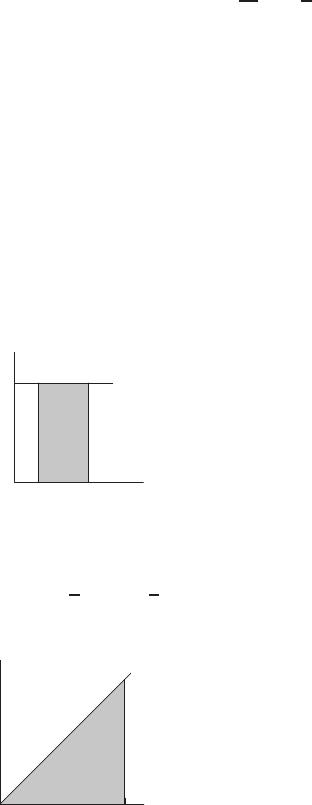
16.2 SOLUTIONS 1471
9. Calculating the inner integral first, we have
Z1
0Z1
0
yexy dx dy =Z1
0 exy
1
0!dy =Z1
0ey−e0dy =Z1
0
(ey−1) dy = (ey−y)
1
0
=e1−1−(e0−0) = e−2.
10. Calculating the inner integral first, we have
Z2
0Zy
0
ydx dy =Z2
0
yx
y
0
dy =Z2
0
y2dy =y3
3
2
0
=8
3.
11. Calculating the inner integral first, we have
Z3
0Zy
0
sin x dx dy =Z3
0−cos x
y
0dy =Z3
0
(−cos y+ 1) dy = (−sin y+y)
3
0
=−sin 3 + 3.
12. Calculating from the inside and using integration by parts, we have
Zπ/2
0Zsin x
0
xdy dx =Zπ/2
0
xy
sin x
0
dx =Zπ/2
0
xsin x dx = (−xcos x+ sin x)
π/2
0
= 1.
13. Z3
1Z4
0
ex+ydxdy =Z3
1
exey
4
0
dx =Z3
1
ex(e4−1) dx = (e4−1)(e2−1)e. See Figure 16.8.
1 3
y= 4
x
y
Figure 16.8
14. Z2
0Zx
0
ex2dydx =Z2
0
ex2y
x
0
dx =Z2
0
xex2dx =1
2ex2
2
0
=1
2(e4−1). See Figure 16.9.
22
x
y
y=x
Figure 16.9
15.
Z5
1Z2x
x
sin x dy dx =Z5
1
sin x·y2x
xdx
=Z5
1
sin x·x dx
= (sin x−xcos x)5
1
= (sin 5 −5 cos 5) −(sin 1 −cos 1) ≈ −2.68.
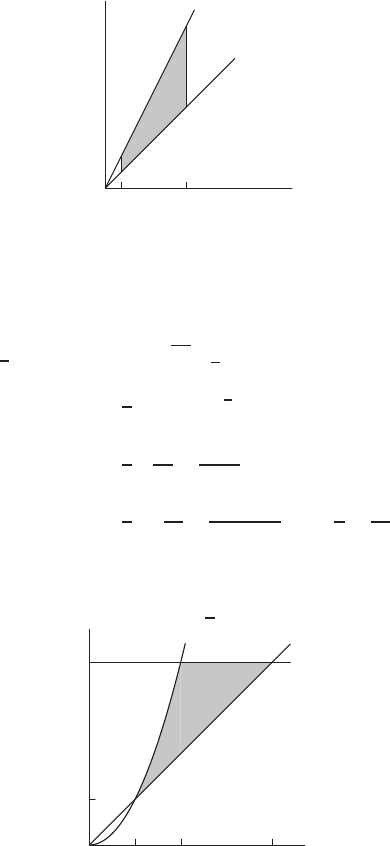
1472 Chapter Sixteen /SOLUTIONS
See Figure 16.10.
1 5
x
y
y=x
y= 2x
Figure 16.10
16.
Z4
1Zy
√y
x2y3dx dy =Z4
1
y3x3
3
y
√y
dy
=1
3Z4
1
(y6−y9
2)dy
=1
3y7
7−y11/2
11/2
4
1
=1
347
7−411/2×2
11 −1
7−2
11 ≈656.082
See Figure 16.11.
1 2 4
1
4
x
y
y= 4
y=x
x=√y
Figure 16.11
17. Z4
1Z2
1
f dy dx or Z2
1Z4
1
f dx dy
18. This region lies between x= 0 and x= 4 and between the lines y= 3xand y= 12, and so the iterated integral is
Z4
0Z12
3x
f(x, y)dydx.
Alternatively, we could have set up the integral as follows:
Z12
0Zy/3
0
f(x, y)dxdy.

16.2 SOLUTIONS 1473
19. The line connecting (−1,1) and (3,−2) is
3x+ 4y= 1
or
y=1−3x
4
So the integral becomes Z3
−1Z(1−3x)/4
−2
f dy dx or Z1
−2Z(1−4y)/3
−1
f dx dy
20. The line on the left (through points (0,0) and (3,6)) is the line y= 2x; the line on the right (through points (3,6) and
(5,0)) is the line y=−3x+ 15. See Figure 16.12. One way to set up this iterated integral is:
Z6
0Z(15−y)/3
y/2
f(x, y)dxdy.
The other option for setting up this integral requires two separate integrals, as follows:
Z3
0Z2x
0
f(x, y)dydx +Z5
3Z−3x+15
0
f(x, y)dydx.
R
y= 2x
y=−3x+ 15
x
y
Figure 16.12
21. Two of the sides of the triangle have equations x=y−1
2and x=y−5
−2. So the integral is
Z3
1Z−1
2(y−5)
1
2(y−1)
f dx dy
22. The line connecting (1,0) and (4,1) is
y=1
3(x−1)
So the integral is Z4
1Z2
(x−1)/3
f dy dx
23.
ZR
√x+y dA =Z2
0Z1
0
√x+y dx dy
=Z2
0
2
3(x+y)3
2
1
0
dy
=2
3Z2
0
((1 + y)3
2−y3
2)dy
=2
3·2
5[(1 + y)5
2−y5
2]
2
0
=4
15 ((3 5
2−25
2)−(1 −0))
=4
15 (9√3−4√2−1) = 2.38176
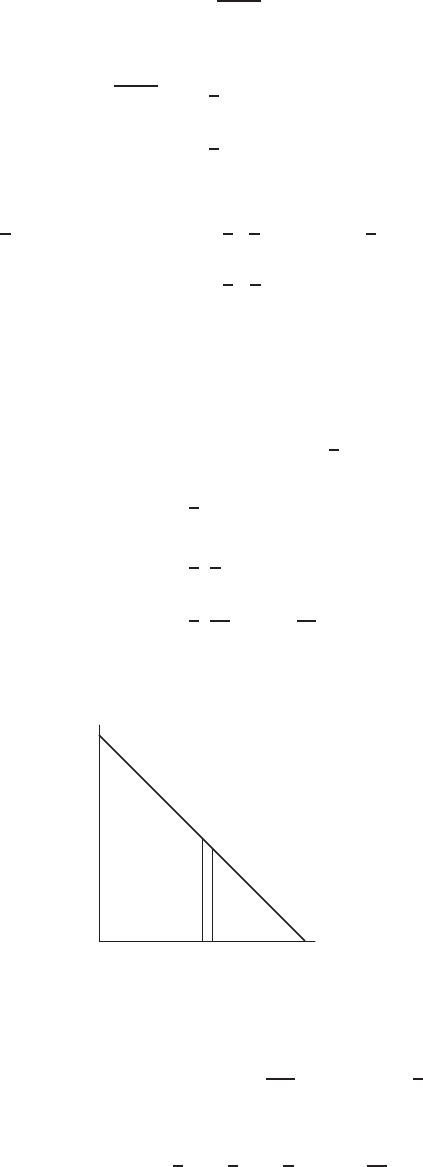
1474 Chapter Sixteen /SOLUTIONS
24. In the other order, the integral is Z1
0Z2
0
√x+y dy dx.
First we keep xfixed and calculate the inside integral with respect to y:
Z2
0
√x+y dy =2
3(x+y)3/2
y=2
y=0
=2
3(x+ 2)3/2−x3/2.
Then the outside integral becomes
Z1
0
2
3(x+ 2)3/2−x3/2dx =2
3h2
5(x+ 2)5/2−2
5x5/2i
1
0
=2
3·2
535/2−1−25/2= 2.38176
Note that the answer is the same as the one we got in Exercise 23.
25.
ZR
(5x2+ 1) sin 3y dA =Z1
−1Zπ/3
0
(5x2+ 1) sin 3y dy dx
=Z1
−1
(5x2+ 1) −1
3cos 3y
π/3
0dx
=2
3Z1
−1
(5x2+ 1) dx
=2
3(5
3x3+x)
1
−1
=2
3(10
3+ 2) = 32
9
26. The region of integration, R, is shown in Figure 16.13.
1
1
y= 1 −x
x
y
Figure 16.13
Integrating first over y, as shown in the diagram, we obtain
ZR
xy dA =Z1
0Z1−x
0
xy dydx =Z1
0
xy2
2
1−x
0
dx=Z1
0
1
2x(1 −x)2dx
Now integrating with respect to xgives
ZR
xy dA =1
4x2−1
3x3+1
8x4
1
0
=1
24 .
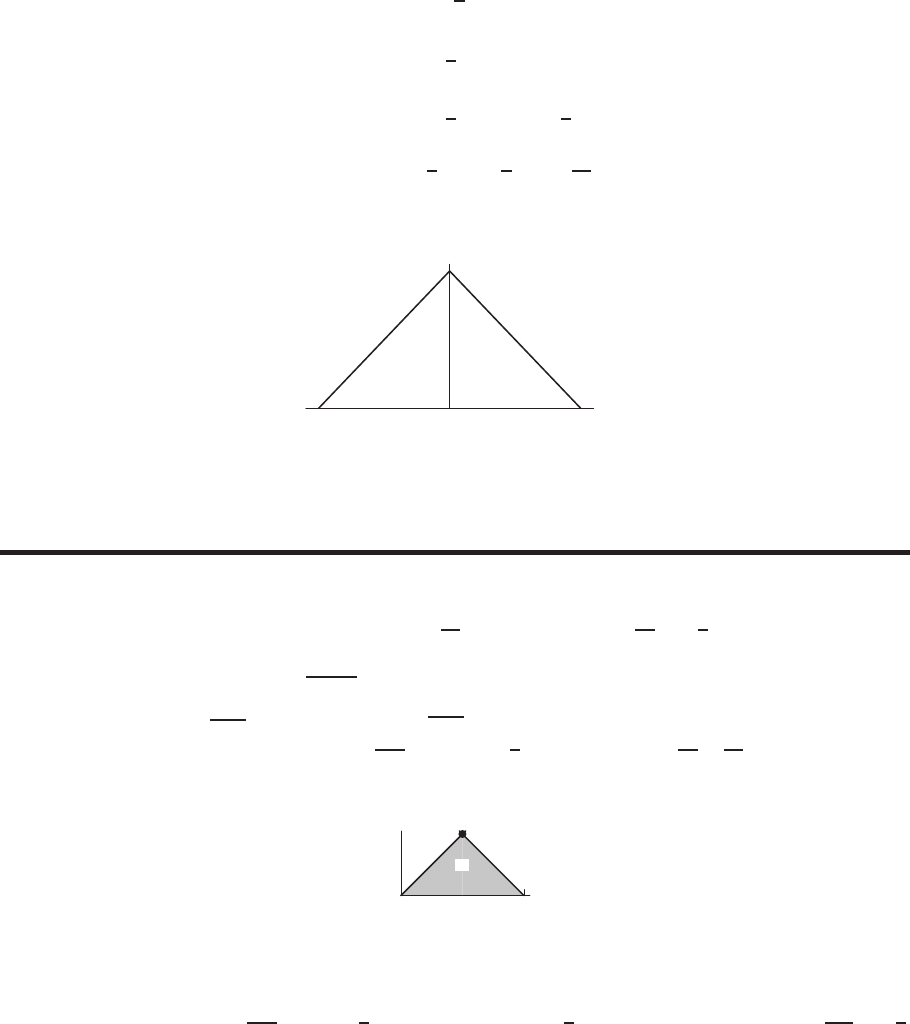
16.2 SOLUTIONS 1475
27. It would be easier to integrate first in the xdirection from x=y−1to x=−y+ 1, because integrating first in the y
direction would involve two separate integrals.
ZR
(2x+ 3y)2dA =Z1
0Z−y+1
y−1
(2x+ 3y)2dx dy
=Z1
0Z−y+1
y−1
(4x2+ 12xy + 9y2)dx dy
=Z1
04
3x3+ 6x2y+ 9xy2−y+1
y−1
dy
=Z1
0
[8
3(−y+ 1)3+ 9y2(−2y+ 2)] dy
=−2
3(−y+ 1)4−9
2y4+ 6y31
0
=−2
3(−1) −9
2+ 6 = 13
6
See Figure 16.14.
x
y
−1 1
1
y=−x+ 1y=x+ 1
Figure 16.14
Problems
28. The diagonal line has equation y= 2x. Integrating with respect to yfirst gives
Z1
0Z2x
0
xy dy dx =Z1
0
xy2
2
2x
0
dx =Z1
0
2x3dx =x4
2
1
0
=1
2.
29. The right half of the circle is x=p1−y2. Integrating with respect to xfirst, we have
Z1
−1Z√1−y2
0
xy dx dy =Z1
−1
x2y
2
√1−y2
0
dy =1
2Z1
−1
(1 −y2)y dy =y2
4−y4
8
1
−1
= 0.
30.
2
R
(1,1)
x
y
The edges of the triangle are the lines y=xon the left and y= 2 −xon the right. We integrate with respect to x
first, giving
Z1
0Z2−y
y
xy dx dy =Z1
0
x2y
2
2−y
y
dy =1
2Z1
0
((2−y)2y−y3)dy =1
2Z1
0
(4y−4y2+y3−y3)dy =y2−2y3
3
1
0
=1
3.
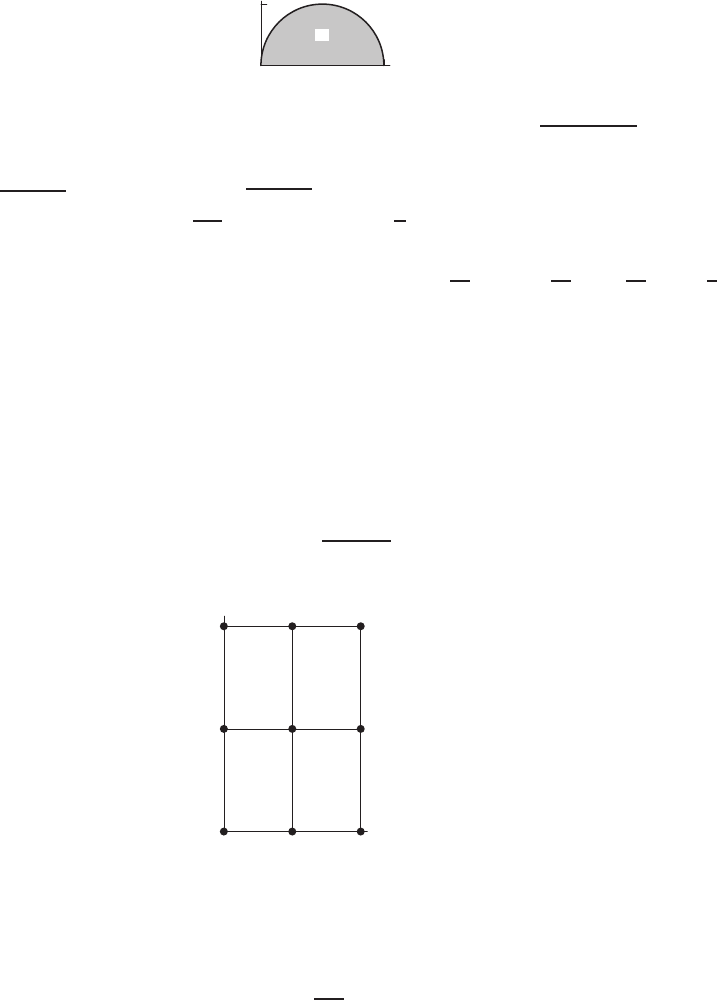
1476 Chapter Sixteen /SOLUTIONS
31.
2
1
R
x
y
The circle has equation (x−1)2+y2= 1; thus the top half has equation y=p1−(x−1)2. Integrating with
respect to yfirst gives
Z2
0Z√1−(x−1)2
0
xy dy dx =Z2
0
xy2
2
√1−(x−1)2
0
dx =Z2
0
x
2(1 −(x−1)2)dx
=Z2
0x2−x3
2dx =x3
3−x4
8
2
0
=2
3.
32. (a) We divide the base region into four subrectangles as shown in Figure 16.15. The height of the object at each point
(x, y)is given by f(x, y) = xy, we label each corner of the subrectangles with the value of the function at that point.
(See Figure 16.15.) Since Volume =Height ×Length ×Width, and ∆x= 2 and ∆y= 3, we have
Overestimate = (12 + 24 + 6 + 12)(2)(3) = 324,
and
Underestimate = (0 + 6 + 0 + 0)(2)(3) = 36.
We average these to obtain
Volume ≈324 + 36
2= 180.
2 4
3
6
f= 0
f= 0
f= 0
f= 0
f= 6
f= 12
f= 0
f= 12
f= 24
x
y
Figure 16.15
(b) We have f(x, y) = xy, so
Volume =Z4
0Z6
0
xy dydx =Z4
0xy2
2
y=6
y=0
dx =Z4
0
18x dx = 9x2
4
0
= 144.
The volume of this object is 144. Notice that 144 is between the over- and underestimates, 324 and 36, found in
part (a).

16.2 SOLUTIONS 1477
33. As given, the region of integration is as shown in Figure 16.16.
1
1
x
y
x=yx= 1
Figure 16.16
Reversing the limits gives
Z1
0Zx
0
ex2dydx =Z1
0yex2
x
0dx =Z1
0
xex2dx
=ex2
2
1
0
=e−1
2.
34. The function sin (x2)has no elementary antiderivative, so we try integrating with respect to yfirst. The region of integra-
tion is shown in Figure 16.17. Changing the order of integration, we get
Z1
0Z1
y
sin (x2)dx dy =Z1
0Zx
0
sin (x2)dy dx
=Z1
0
sin (x2)·y
x
0
dx
=Z1
0
sin (x2)·x dx
=−cos (x2)
2
1
0
=−cos 1
2+1
2=1
2(1 −cos 1) = 0.23.
x
y
y=x
1
Figure 16.17

1478 Chapter Sixteen /SOLUTIONS
35. As given, the region of integration is as shown in Figure 16.18.
x
y
1
1
x= 1
x=√y
Figure 16.18
Reversing the limits gives
Z1
0Zx2
0p2 + x3dydx =Z1
0
(yp2 + x3
x2
0
)dx
=Z1
0
x2p2 + x3dx
=2
9(2 + x3)3
2
1
0
=2
9(3√3−2√2).
36. As given, the region of integration is as shown in Figure 16.19.
9
x
y
3
x= 9
x=y2
Figure 16.19
Reversing the limits gives
Z9
0Z√x
0
ysin (x2)dydx =Z9
0 y2sin (x2)
2
√x
0!dx
=1
2Z9
0
xsin (x2)dx
=−cos (x2)
4
9
0
=1
4−cos (81)
4= 0.056.
37. The region of the integration is shown in Figure 16.20. To make the integration easier, we want to change the order of the
integration and get
Z1
0Ze
ey
x
ln xdx dy =Ze
1Zln x
0
x
ln xdy dx
=Ze
1
x
ln x·y
ln x
0
dx
=Ze
1
x dx =x2
2
e
1
=1
2(e2−1).
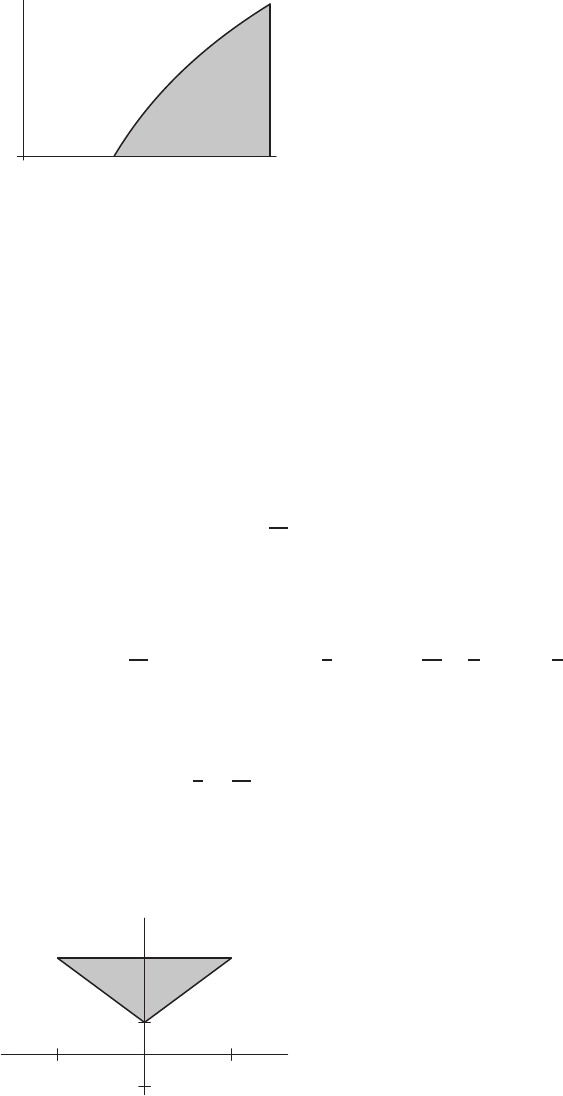
16.2 SOLUTIONS 1479
x
y
1e
(e, 1)
Figure 16.20
38. The region is bounded by x= 1,x= 4,y= 2, and y= 2x. Thus
Volume =Z4
1Z2x
2
(6x2y)dydx.
To evaluate this integral, we evaluate the inside integral first:
Z2x
2
(6x2y)dy = (3x2y2)
2x
2
= 3x2(2x)2−3x2(22) = 12x4−12x2.
Therefore, we have
Z4
1Z2x
2
(6x2y)dydx =Z4
1
(12x4−12x2)dx =12
5x5−4x3
4
1
=2203.2.
The volume of this object is 2203.2.
39. (a) The volume is given by
V=Z1
−1Z1
−1
x2+y2dy dx =Z1
−1
x2y+y3
3
1
−1
dx= 2 Z1
−1x2+1
3dx =2x3
3+x
3
1
−1
=8
3.
(b) The region above the surface, together with the region whose volume we found in part (a), make up a box with a
square base of side 2 and height 2. The volume of the box is 2·2·2 = 8, the volume under the surface is
V= 8 −8
3=16
3.
40. The region is bounded by x= 1 −y,x=y−1,y= 1, and y= 3. See Figure 16.21. To evaluate this integral we
integrate with respect to xfirst, giving
−2 2
−1
1
3
(-2,3) (2,3)
y= 3
x=y−1x= 1 −y
x
y
Figure 16.21

1480 Chapter Sixteen /SOLUTIONS
Z ZR
(2x2+y)dA =Z3
1Zy−1
1−y
(2x2+y)dx dy
=Z3
1
2x3
3+yx
y−1
1−y
dy = 2 Z3
1
2(y−1)3
3+y(y−1) dy
= 2 Z3
1
2y3
3−y2+y−2
3dy
=44
3
41. (a) See Figure 16.22.
y=x x +y= 1
(1/2,1/2)
R
x
y
Figure 16.22
(b) If we integrate with respect to xfirst, we have
ZR
f(x, y)dA =Z1/2
0Z1−y
y
f(x, y)dx dy.
If we integrate with respect to yfirst, the integral must be split into two parts, so
ZR
f(x, y)dA =Z1/2
0Zx
0
f(x, y)dy dx +Z1
1/2Z1−x
0
f(x, y)dy dx.
(c) If f(x, y) = x,
ZR
xdA =Z1/2
0Z1−y
y
x dx dy =Z1/2
0
x2
2
1−y
y
dy
=1
2Z1/2
0
(1 −y)2−y2dy =1
2Z1/2
0
1−2y dy
=1
2(y−y2)
1/2
0
=1
8.
Alternatively,
ZR
xdA =Z1/2
0Zx
0
xdy dx +Z1
1/2Z1−x
0
x dy dx
=Z1/2
0
xy
x
0
dx +Z1
1/2
xy
1−x
0
dx
=Z1/2
0
x2dx +Z1
1/2
x(1 −x)dx
=x3
3
1/2
0
+x2
2−x3
3
1
1/2
=1
24 +1
2−1
3−1
8+1
24 =1
8.
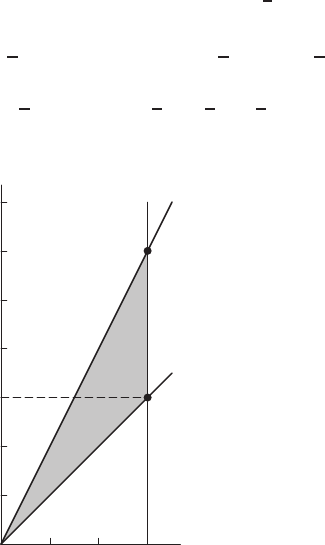
16.2 SOLUTIONS 1481
42. (a) The line x=y/2is the line y= 2x, and y=xand y= 2xintersect at x= 0. Thus, Ris the shaded region in
Figure 16.23. One expression for the integral is
ZR
fdA =Z3
0Z2x
x
x2ex2dy dx.
Another expression is obtained by reversing the order of integration. When we do this, it is necessary to split Rinto
two regions on a line parallel to the x-axis along the point of intersection of y=xand x= 3; this line is y= 3.
Then we obtain ZR
fdA =Z3
0Zy
y/2
x2ex2dx dy +Z6
3Z3
y/2
x2ex2dx dy.
(b) We evaluate the first integral. Integrating with respect to yfirst:
Z3
0Z2x
x
x2ex2dy dx =Z3
0
(x2ex2y)
2x
x
dx =Z3
0
x3ex2dx.
We use integration by parts with u=x2,v′=xex2. Then u′=2xand v=1
2ex2, so
Z3
0
x3ex2dx =1
2x2ex2
3
0−Z3
0
xex2dx =1
2x2ex2
3
0−1
2ex2
3
0
=1
2(9)e9−0−1
2e9−1
2=1
2+ 4e9.
123
1
2
3
4
5
6
7
(3,3)
(3,6)
y= 2x
y=x
x
y
Figure 16.23
43. To find the average value, we evaluate the integral
Z3
0Z6
0
(x2+ 4y)dydx,
and then divide by the area of the base region.
To evaluate this integral, we evaluate the inside integral first:
Z6
0
(x2+4y)dy = (x2y+ 2y2)
y=6
y=0
= 6x2+ 72.

1482 Chapter Sixteen /SOLUTIONS
Therefore, we have
Z3
0Z6
0
(x2+ 4y)dydx =Z3
0
(6x2+ 72)dx = (2x3+ 72x)
3
0
= 270.
The value of the integral is 270. The area of the base region is 3·6 = 18. To find the average value of the function, we
divide the value of the integral by the area of the base region:
Average value =1
Area Z3
0Z6
0
(x2+ 4y)dydx =1
18 ·270 = 15.
The average value is 15. This is reasonable, since the smallest value of f(x, y)on this region is 0, and the largest value is
32+ 4 ·6 = 33.
44. To find the average value, we first find the value of the integral
Z4
0Z3
0
(xy2)dydx.
We evaluate the inside integral first: Z3
0
(xy2)dy =xy3
3
y=3
y=0
= 9x.
Therefore, we have Z4
0Z3
0
(xy2)dydx =Z4
0
(9x)dx =9x2
2
4
0
= 72.
The value of the integral is 72. To find the average value, we divide the value of the integral by the area of the region:
Average value =1
Area Z4
0Z3
0
(xy2)dydx =72
3·4= 6.
The average value of f(x, y)on this rectangle is 6. This is reasonable since the smallest value of xy2on this region is 0
and the largest value is 4·32= 36.
45. The intersection of the graph of f(x, y) = 25 −x2−y2and xy-plane is a circle x2+y2= 25. The given solid is shown
in Figure 16.24.
xy
z
f(x, y) = 25 −x2−y2
Figure 16.24
Thus the volume of the solid is
V=ZR
f(x, y)dA
=Z5
−5Z√25−y2
−√25−y2
(25 −x2−y2)dx dy.
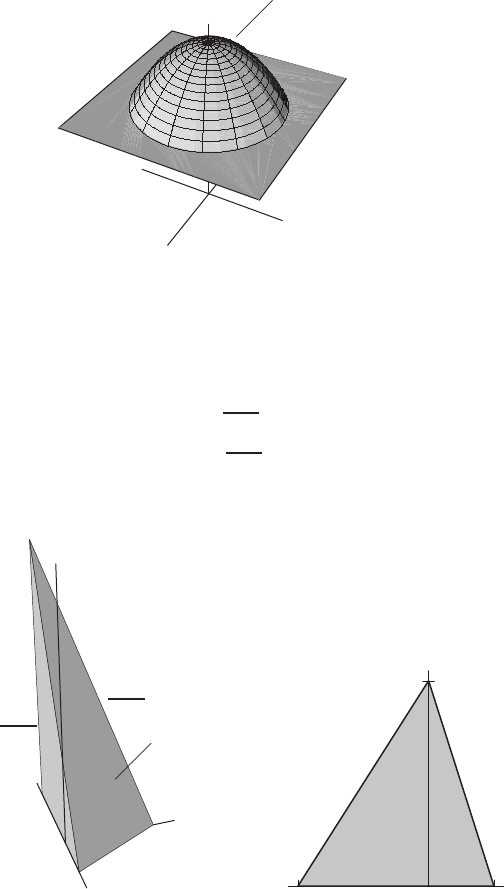
16.2 SOLUTIONS 1483
46. The intersection of the graph of f(x, y) = 25 −x2−y2and the plane z= 16 is a circle, x2+y2= 32. The given solid
is shown in Figure 16.25.
x
y
z✠
f(x, y) = 25 −x2−y2
z=16
Figure 16.25
Thus, the volume of the solid is
V=ZR
(f(x, y)−16) dA
=Z3
−3Z√9−y2
−√9−y2
(9 −x2−y2)dx dy.
47. The solid is shown in Figure 16.26, and the base of the integral is the triangle as shown in Figure 16.27.
x
y
z
2
−4
4
✛y−x= 4
backside
✠
2x+y+z= 4
✲
y= 0
Figure 16.26
−4 2
4
x
y
y−x= 4 2x+y= 4
Figure 16.27
Thus, the volume of the solid is
V=ZR
z dA
=ZR
(4−2x−y)dA
=Z4
0Z(4−y)/2
y−4
(4 −2x−y)dx dy.
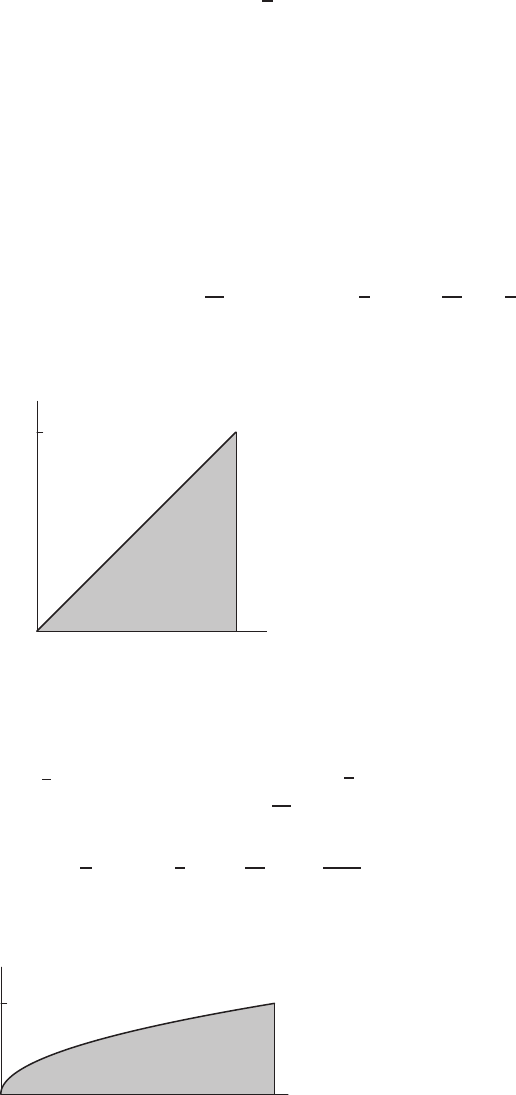
1484 Chapter Sixteen /SOLUTIONS
48.
Volume =Z2
0Z2
0
xy dy dx =Z2
0
1
2xy2
2
0
dx
=Z2
0
2xdx
=x2
2
0
= 4
49. The region of integration is shown in Figure 16.28. Thus
Volume =Z1
0Zx
0
(x2+y2)dy dx =Z1
0x2y+y3
3
y=x
y=0
dx =Z1
0
4
3x3dx =x4
3
1
0
=1
3.
1
1
x
y
x=yx= 1
Figure 16.28
50. The region of integration is shown in Figure 16.29. Thus,
Volume =Z9
0Z√x
0
(x+y)dy dx =Z9
0xy +y2
2
y=√x
y=0
dx
=Z9
0x3/2+x
2dx =2
5x5/2+x2
4
9
0
=2349
20 = 117.45.
9
x
y
3
x= 9
x=y2
Figure 16.29
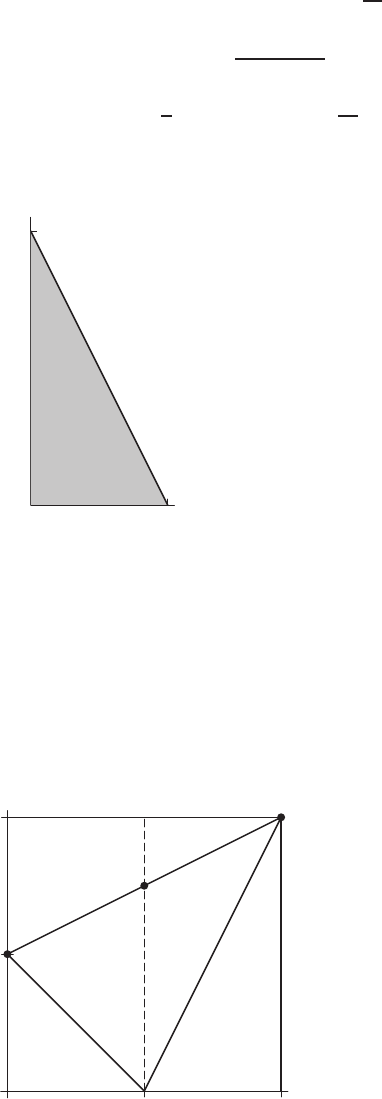
16.2 SOLUTIONS 1485
51. The plane 2x+y+z= 4 cuts the xy-plane in the line 2x+y= 4, so the region of integration is the triangle shown in
Figure 16.30. We want to find the volume under the graph of z= 4 −2x−y. Thus,
Volume =Z2
0Z−2x+4
0
(4 −2x−y)dy dx =Z2
04y−2xy−y2
2
−2x+4
0
dx
=Z2
04(−2x+4) −2x(−2x+ 4) −(−2x+ 4)2
2dx
=Z2
0
(2x2−8x+ 8) dx =2
3x3−4x2+ 8x
2
0
=16
3.
2
4
x
y
x=−(y−4)/2
or
y=−2x+ 4
Figure 16.30
52. Let Rbe the triangle with vertices (1,0),(2,2) and (0,1). Note that (3x+ 2y+ 1) −(x+y) = 2x+y+ 1 >0for
x, y > 0, so z= 3x+ 2y+ 1 is above z=x+yon R. We want to find
Volume =ZR
((3x+ 2y+ 1) −(x+y)) dA =ZR
(2x+y+ 1) dA.
We need to express this in terms of double integrals.
1 2
1
2
x
y
R1
R2
y=1 + 0.5x
y= 1 −x
y= 2x−2
(2,2)
O
Figure 16.31
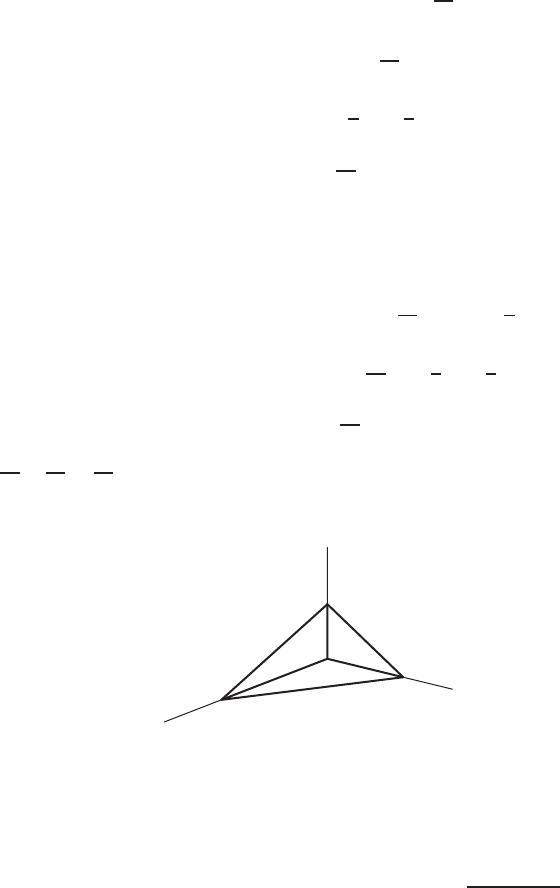
1486 Chapter Sixteen /SOLUTIONS
To do this, divide Rinto two regions with the line x= 1 to make regions R1for x≤1and R2for x≥1. See
Figure 16.31. We want to find
ZR
(2x+y+ 1) dA =ZR1
(2x+y+ 1) dA +ZR2
(2x+y+ 1) dA.
Note that the line connecting (0,1) and (1,0) is y= 1 −x, and the line connecting (0,1) and (2,2) is y= 1 + 0.5x. So
ZR1
(2x+y+ 1) dA =Z1
0Z1+0.5x
1−x
(2x+y+ 1) dy dx.
The line between (1,0) and (2,2) is y= 2x−2, so
ZR2
(2x+y+1) dA =Z2
1Z1+0.5x
2x−2
(2x+y+ 1) dy dx.
We can now compute the double integral for R1:
Z1
0Z1+0.5x
1−x
(2x+y+ 1) dy dx =Z1
02xy+y2
2+y
1+0.5x
1−x
dx
=Z1
021
8x2+ 3xdx
=7
8x3+3
2x2
1
0
dx
=19
8,
and the double integral for R2:
Z2
1Z1+0.5x
2x−2
(2x+y+ 1) dy dx =Z2
1
(2xy +y2/2 + y)
1+0.5x
2x−2
dx
=Z1
0−39
8x2+ 9x+3
2dx
=−13
8x3+9
2x2+3
2x
2
1
=29
8.
So, Volume =19
8+29
8=48
8= 6.
53. We want to calculate the volume of the tetrahedron shown in Figure 16.32.
x
y
z
1/a
1/c
1/b
ax +by = 1
Figure 16.32
We first find the region in the xy-plane where the graph of ax +by +cz = 1 is above the xy-plane. When z= 0
we have ax +by = 1.So the region over which we want to integrate is bounded by x= 0, y = 0 and ax +by = 1.
Integrating with respect to yfirst, we have
Volume =Z1/a
0Z(1−ax)/b
0
z dy dx =Z1/a
0Z(1−ax)/b
0
1−by −ax
cdy dx
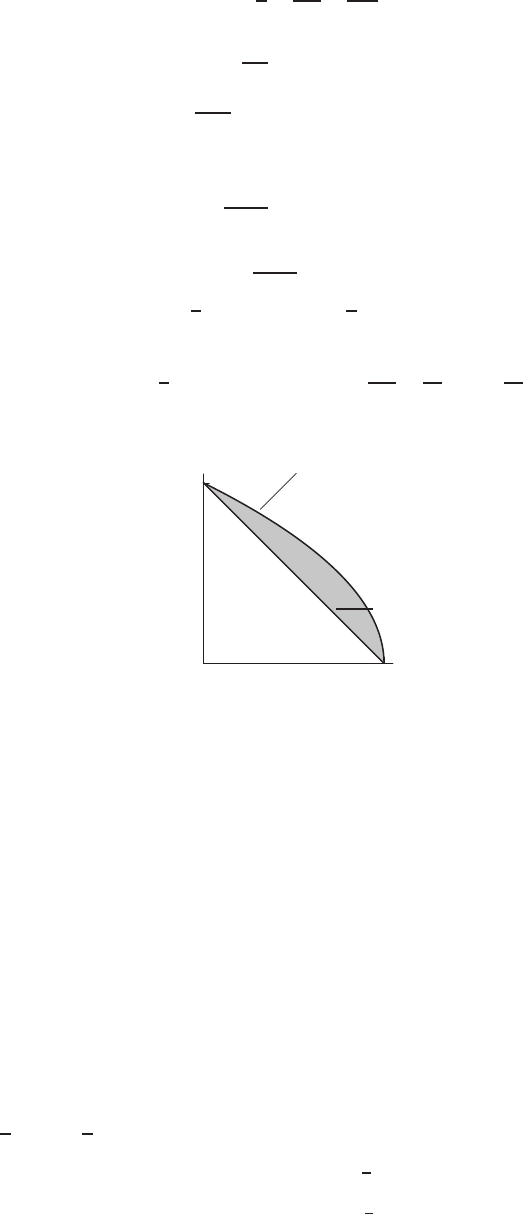
16.2 SOLUTIONS 1487
=Z1/a
0y
c−by2
2c−axy
c
y=(1−ax)/b
y=0
dx
=Z1/a
0
1
2bc (1 −2ax +a2x2)dx
=1
6abc .
54. The region Ris shaded in Figure 16.33. The integral is
ZR
xy dA =Za
0Z√a2−y2
a−y
xy dx dy
=Za
0
1
2x2y
√a2−y2
a−y
dy=1
2Za
0
((a2−y2)y−(a−y)2y)y dy
=1
2Za
0
(2ay2−2y3)dy =ay3
3−y4
4
a
0
=a4
12 .
a
a
✛x+y=a
✠
x2+y2=a2
x
y
Figure 16.33
55. (a) The contour f(x, y) = 1 lies in the xy-plane and has equation
2e−(x−1)2−y2= 1,
so
−(x−1)2−y2= ln(1/2)
(x−1)2+y2= ln 2 = 0.69.
This is the equation of a circle centered at (1,0) in the xy-plane.
Other contours are of the form
2e−(x−1)2−y2=c
−(x−1)2−y2= ln(c/2).
Thus, all the contours are circles centered at the point (1,0).
(b) The cross-section has equation z=f(1, y) = e−y2. If x= 1, the base region in the xy-plane extends from
y=−√3to y=√3. See Figure 16.34, which shows the circular region below Win the xy-plane. So
Area =Z√3
−√3
e−y2dy.
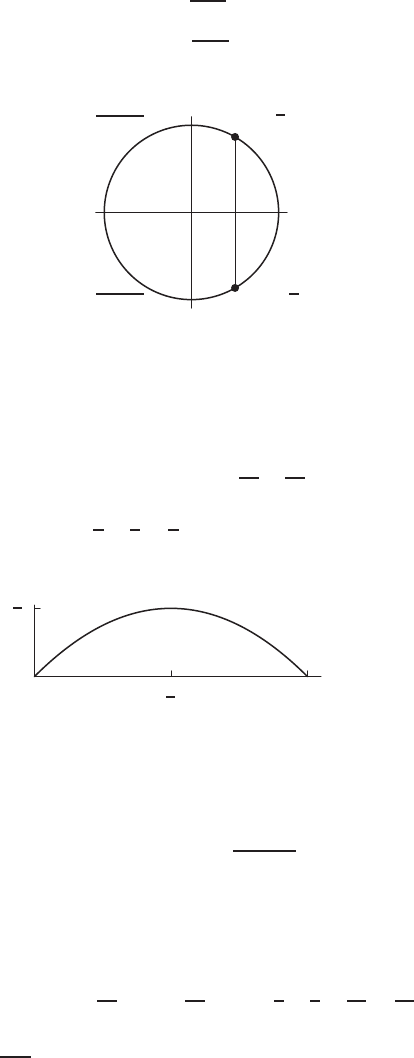
1488 Chapter Sixteen /SOLUTIONS
(c) Slicing parallel to the y-axis, we get
Volume =Z2
−2Z√4−x2
−√4−x2
e−(x−1)2−y2dy dx.
−2 2
−2
2(1,√3)
y=√4−x2
y=−√4−x2(1,−√3)
x
y
Figure 16.34
: Region beneath Win the
xy-plane
56. The region bounded by the x-axis and the graph of y=x−x2is shown in Figure 16.35. The area of this region is
A=Z1
0
(x−x2)dx= ( x2
2−x3
3)
1
0
=1
2−1
3=1
6.
1
21
0
x
y
1
4
Figure 16.35
So the average distance to the x-axis for points in the region is
Average distance =RRydA
area(R)
ZR
y dA =Z1
0 Zx−x2
0
y dy!dx
=Z1
0x2
2−x3+x4
2dx =1
6−1
4+1
10 =1
60 .
Therefore the average distance is 1/60
1/6= 1/10.
57. (a) One solution would be to arrange that the minimum values of fon the square occur at the corners, so that the corner
values give an underestimate of the average. See Figure 16.36.
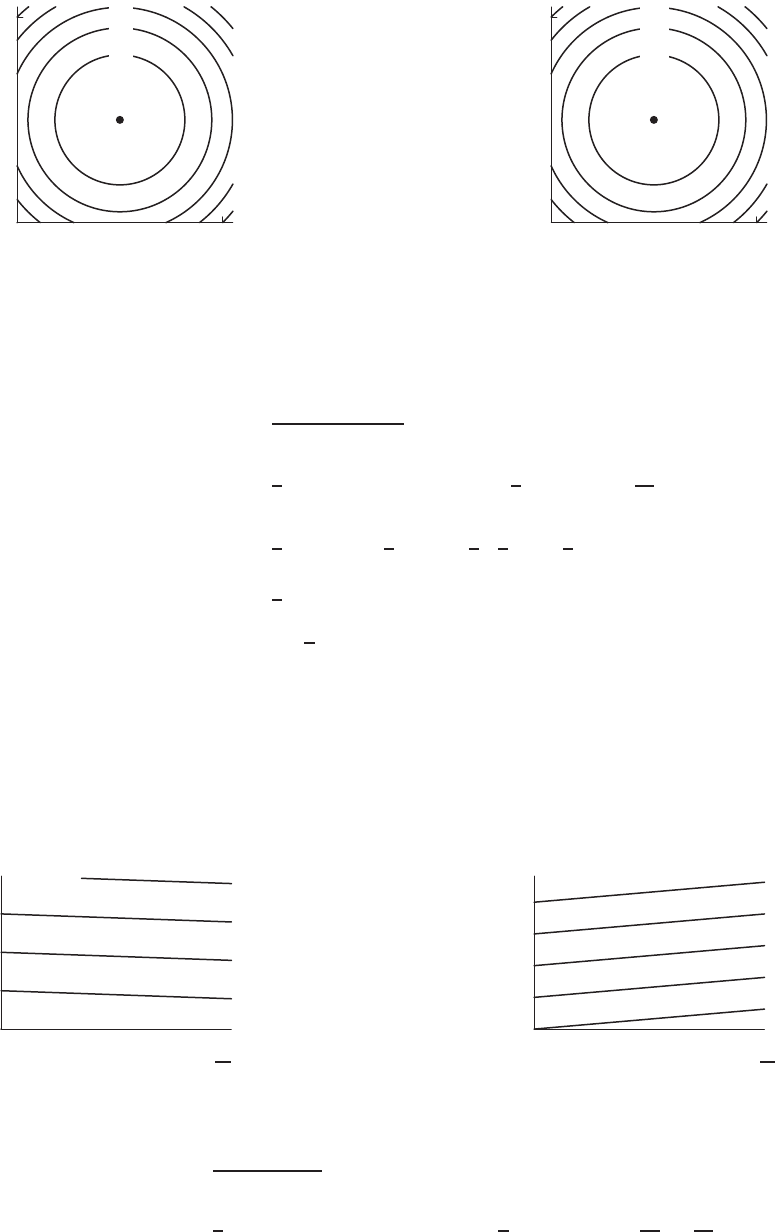
16.2 SOLUTIONS 1489
1
1
100
98
96
94
x
y
Figure 16.36
1
1
0
0.1
0.2
0.3
x
y
Figure 16.37
(b) One solution would be to arrange that the maximum values of fon the square occur at the corners, so that the corner
values give an overestimate of the average. See Figure 16.37.
58. (a) We have
Average value of f=1
Area of Rectangle ZRectangle
f dA
=1
6Z2
x=0 Z3
y=0
(ax +by)dydx =1
6Z2
0axy +by2
2
y=3
y=0
dx
=1
6Z2
03ax +9
2bdx =1
63
2ax2+9
2bx
2
0
=1
6(6a+ 9b)
=a+3
2b.
The average value will be 20 if and only if a+ (3/2)b= 20.
This equation can also be expressed as 2a+ 3b= 40, which shows that f(x, y) = ax +by has average value
of 20 on the rectangle 0≤x≤2,0≤y≤3if and only if f(2,3) = 40.
(b) Since 2a+ 3b= 40, we must have b= (40/3) −(2/3)a. Any function f(x, y) = ax + ((40/3) −(2/3)a)ywhere
ais any real number is a correct solution. For example, a= 1 leads to the function f(x, y) = x+ (38/3)y, and
a=−3leads to the function f(x, y) = −3x+(46/3)y, both of which have average value 20 on the given rectangle.
See Figure 16.38 and 16.39.
x
y
Figure 16.38
:f(x, y) = x+38
3y
x
y
Figure 16.39
:f(x, y) = −3x+46
3y
59. (a) We have
Average value of f=1
Area of Square ZSquare
f dA
=1
4Z2
0Z2
0
(ax2+bxy +cy2)dydx =1
4Z2
0ax2y+bx y2
2+cy3
3
y=2
y=0
dx
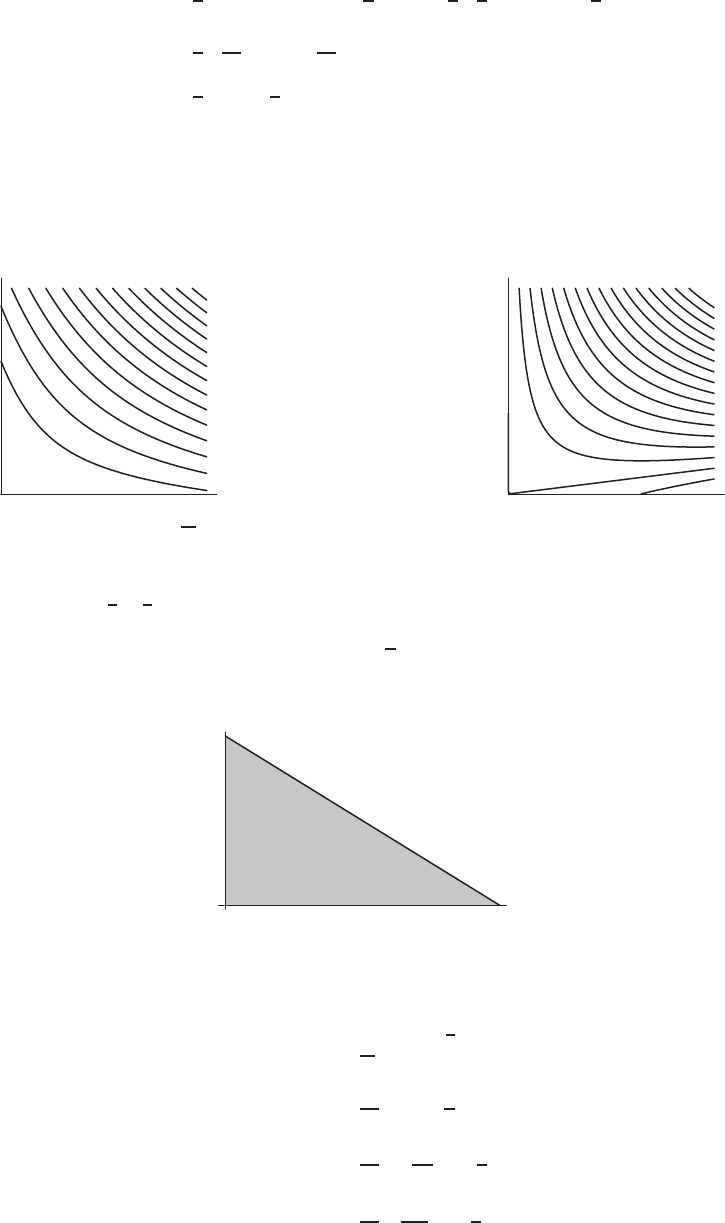
1490 Chapter Sixteen /SOLUTIONS
=1
4Z2
02ax2+ 2bx +8
3cdx =1
42
3ax3+bx2+8
3cx
2
0
=1
416
3a+ 4b+16
3c
=4
3a+b+4
3c
The average value will be 20 if and only if (4/3)a+b+ (4/3)c= 20.
(b) Since (4/3)a+b+ (4/3)c= 20, we must have b= 20 −(4/3)a−(4/3)c. Any function f(x, y) = ax2+ (20 −
(4/3)a−(4/3)c)xy +cy2where aand care any real numbers is a correct solution. For example, a= 1,c= 3 leads
to the function f(x, y) = x2+ (44/3)xy + 3y2, and a=−3,c= 0 leads to the function f(x, y) = −3x2+ 24xy,
both of which have average value 20 on the given square. See Figures 16.40 and 16.41.
x
y
Figure 16.40
:f(x, y) = x2+44
3xy+3y2
x
y
Figure 16.41
:f(x, y) = −3x2+ 24xy
60. Assume the length of the two legs of the right triangle are aand b, respectively. See Figure 16.42. The line through (a, 0)
and (0, b)is given by y
b+x
a= 1. So the area of this triangle is
A=1
2ab.
x
y
b
a
Figure 16.42
Thus the average distance from the points in the triangle to the y-axis (one of the legs) is
Average distance =1
AZa
0Z−b
ax+b
0
x dy dx
=2
ab Za
0−b
ax2+bxdx
=2
ab −b
3ax3+b
2x2
a
0
=2
ab a2b
6=a
3.
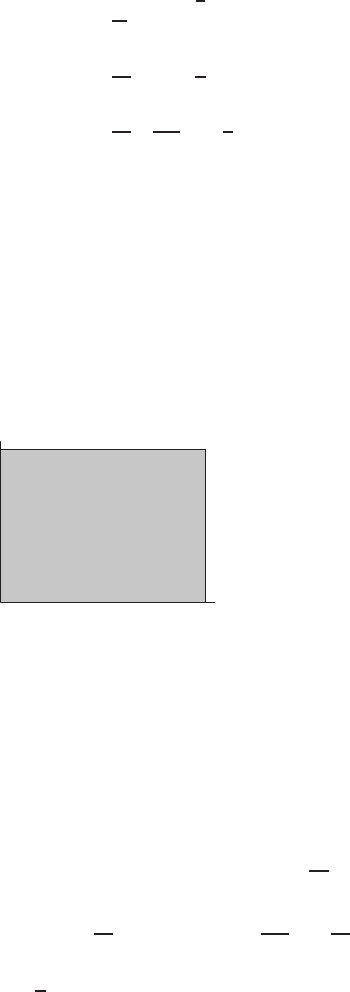
16.2 SOLUTIONS 1491
Similarly, the average distance from the points in the triangle to the x-axis (the other leg) is
Average distance =1
AZb
0Z−a
by+a
0
y dx dy
=2
ab Zb
0−a
by2+aydy
=2
ab ab2
6=b
3.
61. The force, ∆F, acting on ∆A, a small piece of area, is given by
∆F≈p∆A,
where pis the pressure at that point. Thus, if Ris the rectangle, the total force is given by
F=ZR
pdA.
We choose coordinates with the origin at one corner of the plate. See Figure 16.43.
a
b(a, b)
x
y
Figure 16.43
Suppose pis proportional to the square of the distance from the corner represented by the origin. Then we have
p=k(x2+y2),for some positive constant k.
Thus, we want to compute ZR
k(x2+y2)dA. Rewriting as an iterated integral, we have
F=ZR
k(x2+y2)dA=Zb
0Za
0
k(x2+y2)dxdy =kZb
0x3
3+xy2
a
0dy
=kZb
0a3
3+ay2dy =k a3y
3+ay3
3
b
0!
=k
3(a3b+ab3).
62. The outer circle is a semicircle of radius 4. This is shown in Figure 16.44, with center at D. Thus, CE = 2 and DC = 2,
while AD = 4. Notice that angle ADO is a right angle.
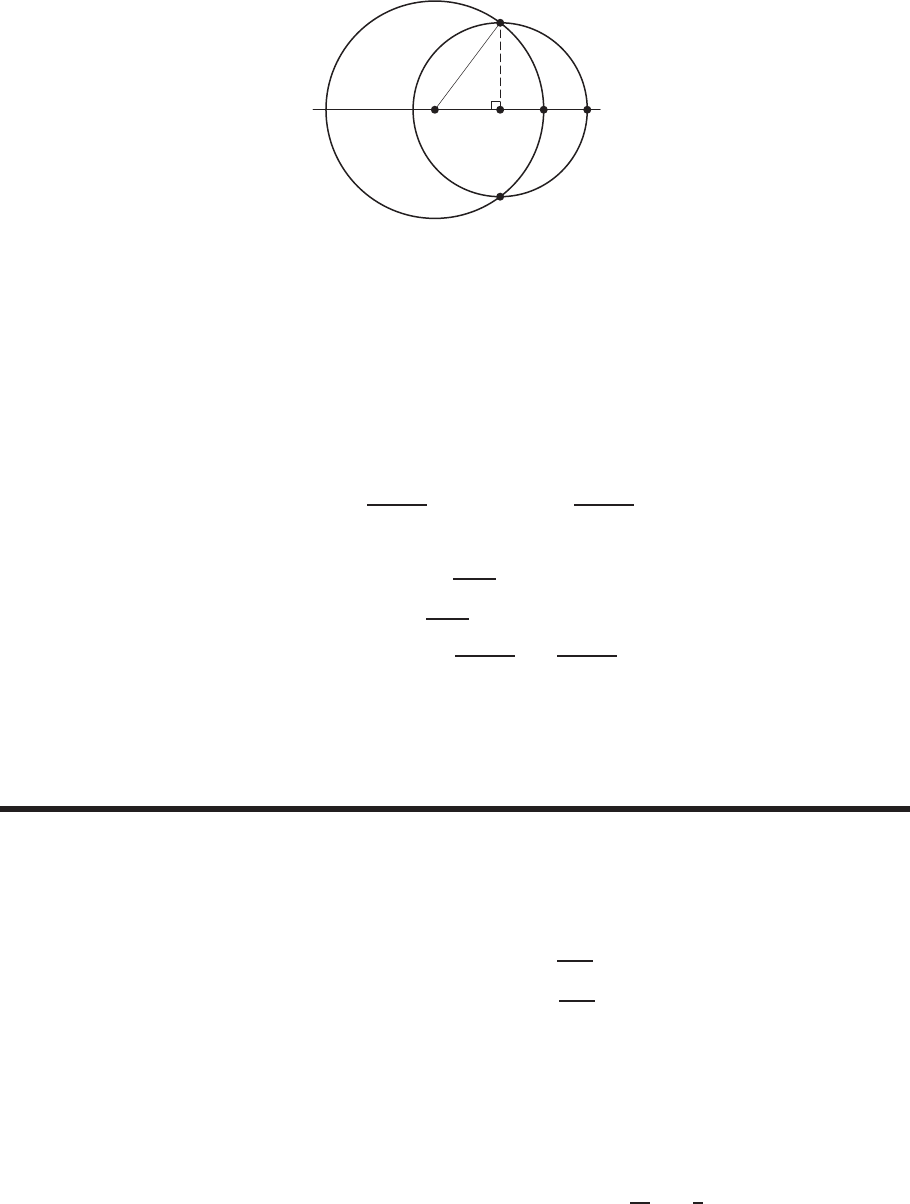
1492 Chapter Sixteen /SOLUTIONS
O
r−2
D
2
C
2
E
A
4
r
B
Figure 16.44
Suppose the large circle has center Oand radius r. Then OA =rand OD =OC −DC =r−2. Applying
Pythagoras’ Theorem to triangle OAD gives
r2= 42+ (r−2)2
r2= 16 + r2−4r+ 4
r= 5.
If we put the origin at O, the equation of the large circle is x2+y2= 25.In the same coordinates, the equation of the
small circle, which has center at D= (3,0), is (x−3)2+y2= 16.The right hand side of the two circles are given by
x=p25 −y2and x= 3 + p16 −y2.
Since the y-coordinate of Ais 4and the y-coordinate of Bis −4, we have
Area =Z4
−4Z3+√16−y2
√25−y2
1dx dy
=Z4
−4
(3 + p16 −y2−p25 −y2)dy
= 13.95.
Strengthen Your Understanding
63. The region of integration for the first integral is the triangle bounded by y= 0, y =xand x= 1. The region for the
second integral is the triangle bounded by x= 0, x =yand y= 1. These are not the same triangle.
64. The integral on the right does not make sense. The outside limits of integration contain a variable, but the outside limits
should always be constants.
65. Suppose the cylinder has height 2 and the base has boundary x2+y2= 1. Then, integrating with respect to yfirst gives
Volume =ZBase
2dA =Z1
−1Z√1−x2
−√1−x2
2dx dy.
66. The region of integration is bounded by the x-axis and the lines y=xand x= 1. Integrating with respect to yfirst, we
have Z1
0Zx
0
f(x, y)dy dx = 4.
We start by trying f(x, y) = x. Since
Z1
0Zx
0
xdy dx =Z1
0
xy
y=x
y=0
dx =Z1
0
x2dx =x3
3
1
0
=1
3,
we take f(x, y) = 12x. Many other answers are possible.
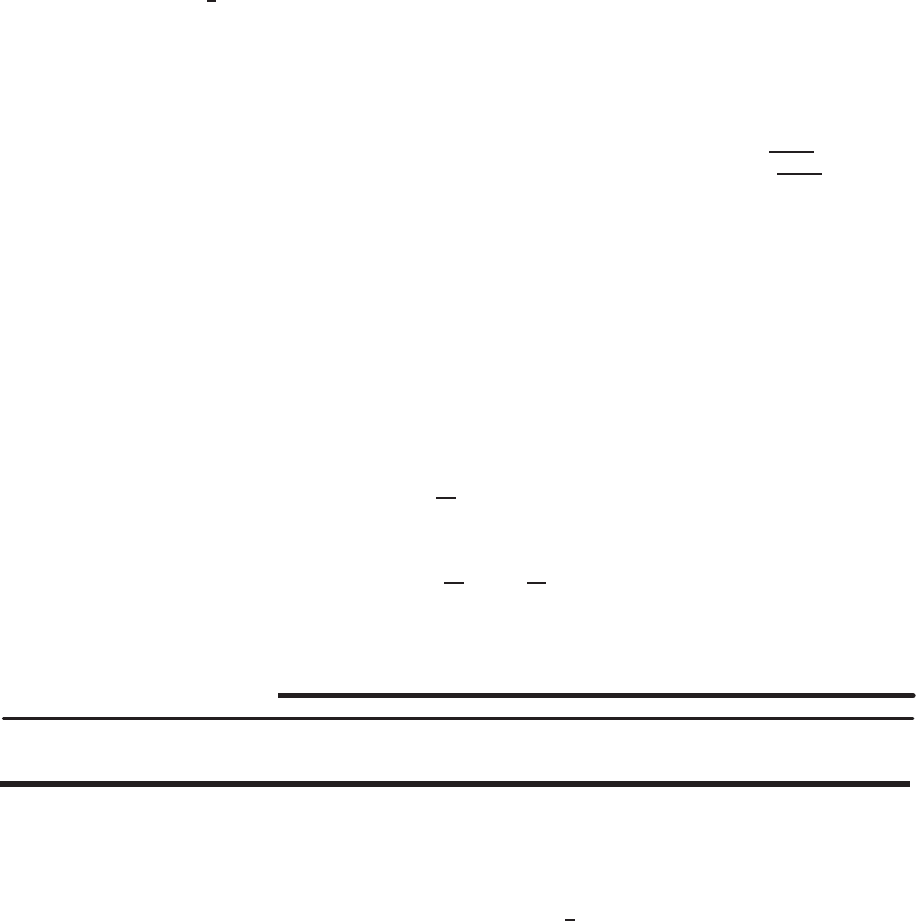
16.3 SOLUTIONS 1493
67. Since the height of the prism is not specified, we can choose any height we wish, for example 1. If the base triangle has
area 6 and the height of the prism is 1 then the volume of the prism is 6. Any right triangle with legs of length 6 and 2 will
work. For example, the triangle with vertices (0,0),(0,2) and (6,0) has area 6. Therefore,
Z2
0Z6−3y
0
1dx dy
represents the volume of a triangular prism whose base has area 6.
68. False. Since the inside integral is performed with respect to xand the outside integral with respect to y, the region of
integration is the rectangle 5≤x≤12,0≤y≤1.
69. False. The iterated integral R2
0R1
0fdxdy is over a rectangle. The correct limits are R1
0R2−x
xf dydx.
70. True. For any point in the region of integration we have 1≤x≤2, and so yis between the positive numbers 1and 8.
71. False. The sign of Rb
aRd
cfdydx depends on the behavior of the function fon the region of integration. For example,
R2
1R2
1(−x)dydx =−3
2.
72. True. Since fdoes not depend on x, the inside integral (which is with respect to x) evaluates to R1
0fdx =xf
x=1
x=0
=
(f−0) = f. Thus Zb
aZ1
0
f dx dy =Zb
a
f dy.
73. False. The given limits describe only the upper half disk where y≥0. The correct limits are Ra
−aR√a2−x2
−√a2−x2fdydx.
74. True. In the inner integral with respect to y, the function g(x)can be treated as a constant, so
Zb
aZd
c
g(x)h(y)dxdy =Zb
a
g(x)Zd
c
h(y)dydx.
The result of the integral Rd
ch(y)dyis a constant, so may be factored out of the integral with respect to x. Thus we have
Zb
a
g(x)Zd
c
h(y)dydx =Zd
c
h(y)dy·Zb
a
g(x)dx.
75. False. As a counterexample, consider R2
0R2
0(x+y)dxdy. We have
Z2
0Z2
0
(x+y)dxdy =Z2
0x2
2+yx
x=2
x=0
dy =Z2
0
(2 + 2y)dy = 8
and Z2
0
xdx +Z2
0
y dy =x2
2
x=2
x=0
+y2
2
y=2
y=0
= 2 + 2 = 4.
Solutions for Section 16.3
Exercises
1.
ZW
fdV =Z2
0Z1
−1Z3
2
(x2+ 5y2−z)dz dy dx
=Z2
0Z1
−1
(x2z+ 5y2z−1
2z2)
3
2
dy dx
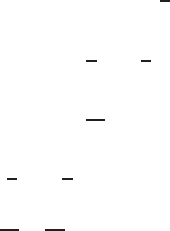
1494 Chapter Sixteen /SOLUTIONS
=Z2
0Z1
−1
(x2+ 5y2−5
2)dy dx
=Z2
0
(x2y+5
3y3−5
2y)
1
−1
dx
=Z2
0
(2x2+10
3−5) dx
= ( 2
3x3−5
3x)
2
0
=16
3−10
3= 2
2.
ZW
fdV =Z1
0Z1
0Z2
0
(ax +by +cz)dz dy dx
=Z1
0Z1
0
(2ax + 2by + 2c)dy dx
=Z1
0
(2ax +b+ 2c)dx
=a+b+ 2c
3.
ZW
fdV =Zπ
0Zπ
0Zπ
0
sin xcos(y+z)dz dy dx
=Zπ
0Zπ
0
sin xsin(y+z)
π
0
dy dx
=Zπ
0Zπ
0
sin x[sin(y+π)−sin y]dy dx
=Zπ
0Zπ
0
sin x(−2 sin y)dy dx
=−2Zπ
0
sin x(−cos y)
π
0
dx
=−2Zπ
0
2sin x dx
=−4(−cos x)
π
0
= (−4)(2) = −8
4.
ZW
fdV =Za
0Zb
0Zc
0
e−x−y−zdz dy dx
=Za
0Zb
0Zc
0
e−xe−ye−zdz dy dx
=Za
0Zb
0
e−xe−y(−e−z)
c
0
dy dx

16.3 SOLUTIONS 1495
=Za
0Zb
0
e−xe−y(−e−c+ 1) dy dx
= (1 −e−c)Za
0
e−x(−e−y)
b
0
dx
= (1 −e−b)(1 −e−c)Za
0
e−xdx
= (1 −e−a)(1 −e−b)(1 −e−c)
5. The region is the half cylinder in Figure 16.45.
xy
z
11
1
Figure 16.45
6. The region is the half cylinder in Figure 16.46.
1
1
1
x
y
z
Figure 16.46
7. The region is the cylinder in Figure 16.47.
x
y
z
1
1
1
Figure 16.47

1496 Chapter Sixteen /SOLUTIONS
8. The region is the half cylinder in Figure 16.48.
11
1
x
y
z
Figure 16.48
9. The region is the hemisphere in Figure 16.49.
11
1
x
y
z
Figure 16.49
10. The region is the quarter sphere in Figure 16.50.
1
1
1
x
y
z
Figure 16.50
11. The region is the quarter sphere in Figure 16.51.
11
1
x
y
z
Figure 16.51
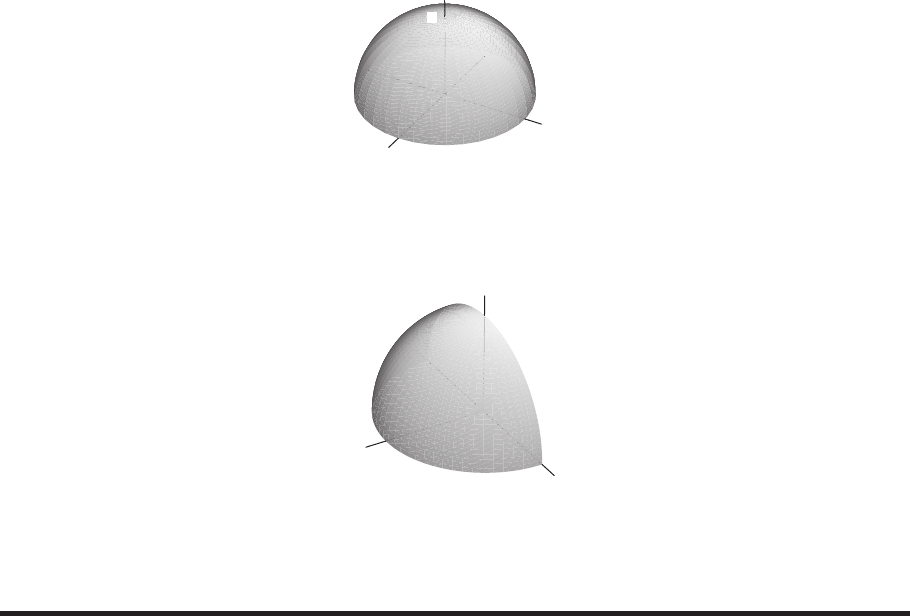
16.3 SOLUTIONS 1497
12. The region is the hemisphere in Figure 16.52.
1
1
1
x
y
z
Figure 16.52
13. The region is the quarter sphere in Figure 16.53.
1
1
1
x
y
z
Figure 16.53
Problems
14. Positive. Since ezis positive on T, its integral is positive.
15. Positive. Since ezis positive on B, its integral is positive.
16. Zero. Since sin zis positive on T, and negative (and of equal absolute value) on B the integral is zero because the integrals
over the two halves of the sphere cancel.
17. Positive. Since sin zis positive on T, its integral is positive.
18. Zero. Since sin zis positive on the upper half of Rand negative ( and of equal absolute value) on the lower half of R, the
integral of sin zis zero because the integrals over the two halves cancel.
19. Zero. The value of yis positive on the half of the cone above the second and third quadrants and negative (of equal
absolute value) on the half of the cone above the third and fourth quadrants. The integral of yover the entire solid cone is
zero because the integrals over the four quadrants cancel.
20. Zero. The value of xis positive above the first and fourth quadrants in the xy-plane, and negative (and of equal absolute
value) above the second and third quadrants. The integral of xover the entire solid cone is zero because the integrals over
the two halves of the cone cancel.
21. Positive. Since zis positive on W, its integral is positive.
22. Zero. You can see this in several ways. One way is to observe that xy is positive on part of the cone above the first and
third quadrants (where xand yare of the same sign) and negative (of equal absolute value) on the part of the cone above
the second and fourth quadrants (where xand yhave opposite signs). These add up to zero in the integral of xy over all
of W.
Another way to see that the integral is zero is to write the triple integral as an iterated integral, say integrating first
with respect to x. For fixed yand z, the x-integral is over an interval symmetric about 0. The integral of xover such an
interval is zero. If any of the inner integrals in an iterated integral is zero, then the triple integral is zero.
23. Zero. Write the triple integral as an iterated integral, say integrating first with respect to x. For fixed yand z, the x-integral
is over an interval symmetric about 0. The integral of xover such an interval is zero. If any of the inner integrals in an
iterated integral is zero, then the triple integral is zero.
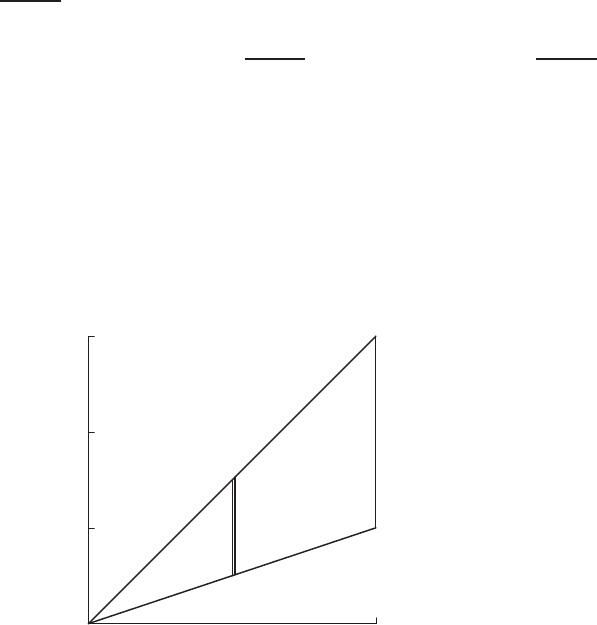
1498 Chapter Sixteen /SOLUTIONS
24. Negative. If (x, y, z)is any point inside the cone then z < 2. Hence the function z−2is negative on Wand so is its
integral.
25. Positive. The function px2+y2is positive, so its integral over the solid Wis positive.
26. Positive. The function e−xyz is a positive function everywhere so its integral over Wis positive.
27. Positive. If (x, y, z)is any point inside the solid Wthen px2+y2< z. Thus the integrand z−px2+y2>0, and so
its integral over the solid Wis positive.
28. Figure 16.54 shows a slice through the region for a fixed x. The required volume, V, is given by
V=Z2
1Z1
0Z3y
y
dz dy dx =Z2
1Z1
0
z
3y
y
dy dx =Z2
1Z1
0
2y dy dx
=Z2
1
y2
1
0
dx =Z2
1
dx = 1.
1
0
1
2
3
z=y
z= 3y
y
z
Figure 16.54
29. The required volume, V, is given by
V=Z5
0Z3
0Zx2
0
dz dy dx
=Z5
0Z3
0
x2dy dx
=Z5
0
x2y
y=3
y=0
dx
=Z5
0
3x2dx
= 125.
30. We have z= 2 −x−y, and the region under the surface in the xy-plane is bounded by the axes and the line x+y= 2
or y= 2 −x. Thus the volume is given by
V=Z2
0Z2−x
0Z2−x−y
0
dz dy dx =Z2
0Z2−x
0
(2 −x−y)dy dx
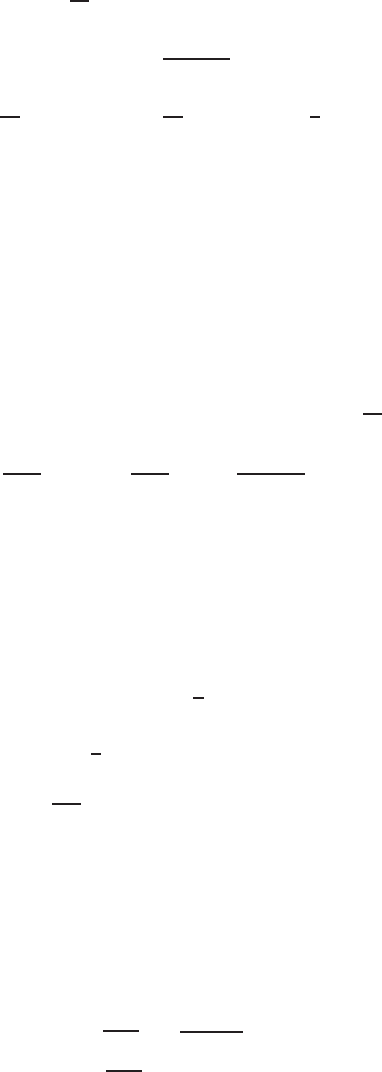
16.3 SOLUTIONS 1499
=Z2
0
2y−xy −y2
2
2−x
0
dx
=Z2
0
2(2 −x)−x(2 −x)−(2 −x)2
2dx
=Z2
0x2
2−2x+ 2dx =x3
6−x2+ 2x
2
0
=4
3
31. (a) Since the trough is symmetric about the xz-plane, we find the mass of sludge in one half and double it. Thus the total
mass is given by
Mass of sludge = 2 Z10
0Z1
0Z1
y
e−3xdz dy dx.
Other orders of integration are possible.
(b) Evaluating gives
Mass = 2 Z10
0Z1
0Z1
y
e−3xdz dy dx = 2 Z10
0Z1
0ze−3x
1
y
dy dx
= 2 Z10
0Z1
0e−3x−ye−3xdy dx = 2 Z10
0ye−3x−y2
2e−3x
1
0
dx
= 2 Z10
0
e−3x
2dx = 2 −e−3x
6
10
0
=1−e−30
3.
32. The required volume, V, is given by
V=Z10
0Z10−x
0Z10
x+y
dzdydx
=Z10
0Z10−x
0
(10 −(x+y)) dydx
=Z10
0h10y−xy −1
2y2iy=10−x
y=0
dx
=Z10
0
1
2(10 −x)2dx
=500
3
33. Since z=x+yis below z= 1 + 2x+ 2yfor x, y ≥0, we have
V=Z1
0Z2
0Z1+2x+2y
x+y
1dz dy dx.
The order of integration of xand ycan be reversed.
34. For x2+y2≤1, the paraboloid z=x2+y2is below the sphere x2+y2+z2= 4, so
V=Z1
−1Z√1−x2
−√1−x2Z√4−x2−y2
x2+y2
1dz dy dx.
The order of integration of xand ycan be reversed.
35. The two surfaces are planes given by
z= 6 −2x−2y
z= 6 −3x−4y.

1500 Chapter Sixteen /SOLUTIONS
For x, y ≥0, the plane z= 6 −2x−2yis above z= 6 −3x−4y. The region in the xy-plane is shown in Figure 16.55.
Thus
V=Z1
0Z1−x
0Z6−2x−2y
6−3x−4y
1dz dy dx.
The order of integration of xand ycan be reversed.
1
1
y= 1 −x
x
y
Figure 16.55
36. The top half of the sphere is given by
z=p9−x2−y2.
The region in the xy-plane is shown in Figure 16.56. If we integrate with respect to yfirst, we have to break the region in
two pieces. Thus it is easier to integrate with respect to xfirst, giving
V=Z2
0Z(y+2)/2
yZ√9−x2−y2
0
1dz dx dy.
1 2
2
y=x
y= 2x−2
x
y
Figure 16.56
37. The sphere x2+y2+z2= 9 intersects the plane z= 2 in the circle
x2+y2+ 22= 9
x2+y2= 5.
The upper half of the sphere is given by z=p9−x2−y2. Thus, using the limits from Figure 16.57 gives
V=Z√5
−√5Z√5−x2
−√5−x2Z√9−x2−y2
2
1dz dy dx.
The order of integration of xand ycan be reversed.

16.3 SOLUTIONS 1501
−√5√5
−√5
√5
y=√5−x2
y=−√5−x2
x
y
Figure 16.57
38. The top half of the sphere is given by
z=p4−x2−y2.
The region in the xy-plane is shown in Figure 16.58. If we integrate with respect to xfirst, we have to break the region
into two pieces. Thus, it is easier to integrate with respect to yfirst, giving
V=Z1
0Z√4−x2
0Z√4−x2−y2
0
1dz dy dx.
1 2
2
x2+y2= 4
x
y
Figure 16.58
39. A slice through Wfor a fixed value of yis a semi-circle the boundary of which is z2=r2−x2, for z≥0, so the inner
integral is
Z√r2−x2
0
f(x, y, z)dz.
Lining up these stacks parallel to x-axis gives a slice from x=−rto x=rgiving
Zr
−rZ√r2−x2
0
f(x, y, z)dz dx.
Finally, there is a slice for each ybetween 0and 1, so the integral we want is
Z1
0Zr
−rZ√r2−x2
0
f(x, y, z)dz dx dy.
40. A slice through Wfor a fixed value of xis a semi-circle the boundary of which is y2= 4 −z2, for y≥0, so the inner
integral is
Z√4−z2
0
f(x, y, z)dy.
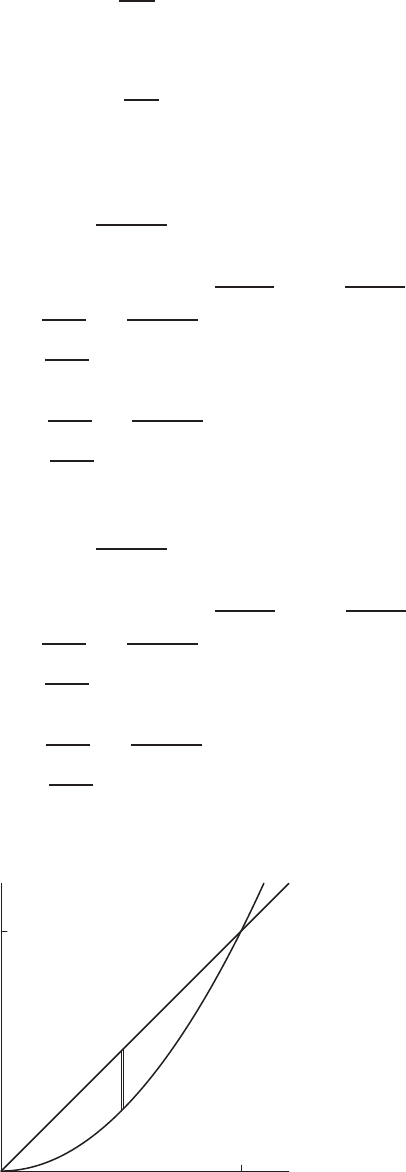
1502 Chapter Sixteen /SOLUTIONS
Lining up these stacks parallel to z-axis gives a slice from z=−2to z= 2 giving
Z2
−2Z√4−z2
0
f(x, y, z)dy dz.
Finally, there is a slice for each xbetween 0and 1, so the integral we want is
Z1
0Z2
−2Z√4−z2
0
f(x, y, z)dy dz dx.
41. A slice through Wfor a fixed value of xis a semi-circle the boundary of which is y2=r2−x2−z2, for y≥0, so the
inner integral is
Z√r2−x2−z2
0
f(x, y, z)dy.
Lining up these stacks parallel to z-axis gives a slice from z=−√r2−x2to z=√r2−x2giving
Z√r2−x2
−√r2−x2Z√r2−x2−z2
0
f(x, y, z)dy dz.
Finally, there is a slice for each xbetween −rand r, so the integral we want is
Zr
−rZ√r2−x2
−√r2−x2Z√r2−x2−z2
0
f(x, y, z)dy dz dx.
42. A slice through Wfor a fixed value of xis a semi-circle the boundary of which is z2=r2−x2−y2, for z≥0, so the
inner integral is
Z√r2−x2−y2
0
f(x, y, z)dz.
Lining up these stacks parallel to y-axis gives a slice from y=−√r2−x2to y=√r2−x2giving
Z√r2−x2
−√r2−x2Z√r2−x2−y2
0
f(x, y, z)dz dy.
Finally, there is a slice for each xbetween 0and r, so the integral we want is
Zr
0Z√r2−x2
−√r2−x2Z√r2−x2−y2
0
f(x, y, z)dz dy dx.
43. Figure 16.59 shows a slice through the region for a fixed value of y.
1
0
1
z=x
z=x2
x
z
Figure 16.59

16.3 SOLUTIONS 1503
We break the region into small cubes of volume ∆V= ∆x∆y∆z. A stack of cubes vertically above the point (x, z)
in the xz-plane gives the strip shown in Figure 16.59 and so the inner integral is
Zx
x2
dz
The plane and the surface meet when x=x2, giving x(1 −x) = 0, so x= 0 or x= 1. Lining up the stacks parallel to
the z-axis gives a slice from x= 0 to x= 1. Thus, the limits on the middle integral are
Z1
0Zx
x2
dz dx.
Finally, there is a slice for each ybetween 0and 3, so the integral we want is
Z3
0Z1
0Zx
x2
dz dx dy.
The required volume, V, is given by
V=Z3
0Z1
0Zx
x2
dz dx dy
=Z3
0Z1
0x−x2dx dy
=Z3
0
x2
2−x3
3
1
0
dy
=Z3
0
1
6dy
=1
6Z3
0
dy
=1
6·3
=1
2.
44. The required volume, V, is given by
V=Z5
0Z5−x
0Zx+y
0
dz dy dx
=Z5
0Z5−x
0
(x+y)dy dx
=Z5
0
xy+1
2y2
y=5−x
y=0
dx
=Z5
0x(5 −x) + 1
2(5 −x)2dx
=125
3.
45. The pyramid is shown in Figure 16.60. The planes y= 0, and y−x= 4, and 2x+y+z= 4 intersect the plane z=−6
in the lines y= 0,y−x= 4,2x+y= 10 on the z=−6plane as shown in Figure 16.61.
These three lines intersect at the points (−4,0,−6),(5,0,−6), and (2,6,−6). Let Rbe the triangle in the planes
z=−6with the above three points as vertices. Then, the volume of the solid is
V=Z6
0Z(10−y)/2
y−4Z4−2x−y
−6
dz dx dy

1504 Chapter Sixteen /SOLUTIONS
=Z6
0Z(10−y)/2
y−4
(10 −2x−y)dx dy = 162
=Z6
0
(10x−x2−xy)
(10−y)/2
y−4
dy
=Z6
0
(9y2
4−27y+ 81) dy
= 162
x
y
z
2
−4
4
✛2x+y+z= 4
✲
y= 0
✛z=−6
bottom
✛y−x= 4
backside
(−4,0,−6)
(5,0,−6)
(2,6,−6)
Figure 16.60
(−4,0,−6) (5,0,−6)
(2,6,−6)
z=−6
plane
x
y
y−x= 4 2x+y−6 = 4
Figure 16.61
46. Since x+y+z= 1 can be written as
z= 1 −x−y,
the plane z= 1 + x+yis above the plane z= 1 −x−yfor x≥0, y ≥0. The region of integration in the xy-plane is
the triangle shown in Figure 16.62. Thus
Volume =Z1
0Z1−x
0Z1+x+y
1−x−y
1dz dy dx =Z1
0Z1−x
1
z
1+x+y
1−x−y
dy dx
=Z1
0Z1−x
0
((1 + x+y)−(1 −x−y)) dy dx =Z1
0Z1−x
0
(2x+ 2y)dy dx =Z1
0
2xy +y2
1−x
0
dx
=Z1
0
(2x(1 −x) + (1 −x)2)dx =Z1
0
(1 −x2)dx =x−x3
3
1
0
=2
3.
1
1
y= 1 −x
x
y
Figure 16.62
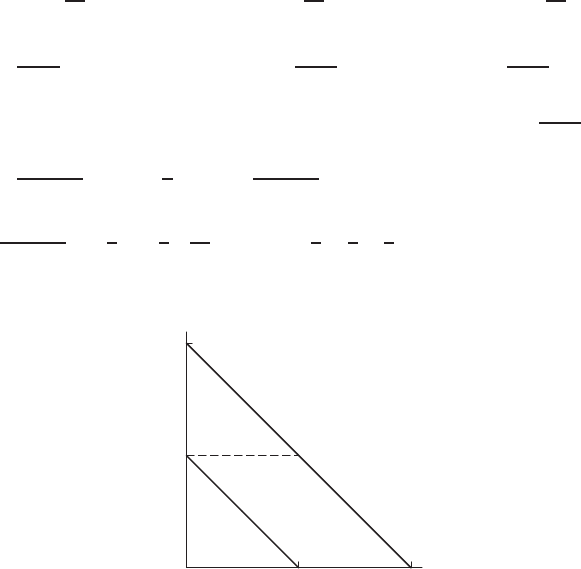
16.3 SOLUTIONS 1505
47. The plane x+y+z= 1 cuts the xy-plane in the line x+y= 1. For x+y < 1, the plane x+y+z= 1 is above the
xy-plane. For 1< x +y≤2, the plane x+y+z= 1 is below the xy-plane. Therefore, z= 1 −x−yis positive for
x+y < 1and negative for 1< x +y < 2. Thus
Volume =Zx+y≤1
(1−x−y)dA −Z1≤x+y≤2
(1 −x−y)dA
From Figure 16.63, we see that the region 1≤x+y≤2must be split into two, for example as shown. Integrating with
respect to xfirst, we have
Volume =Z1
0Z1−y
0
(1−x−y)dx dy −Z1
0Z2−y
1−y
(1 −x−y)dx dy +Z2
1Z2−y
0
(1 −x−y)dx dy
=Z1
0x−x2
2−xy
1−y
0
dy −Z1
0x−x2
2−xy
2−y
1−y
dy −Z2
1x−x2
2−xy
2−y
0
dy
=Z1
0
1−y
2(2 −(1 −y)−2y)dy −Z1
02−y
2(2 −(2 −y)−2y)−1−y
2(2 −(1 −y)−2y)dy
−Z2
1
2−y
2(2 −(2 −y)−2y)dy
=Z1
0
(1 −y)2
2dy +Z1
0
1
2dy −Z2
1
y(y−2)
2dy
=−(1 −y)3
6
1
0
+y
2
1
0
−1
2y3
3−y2
2
1
=1
6+1
2+1
3= 1.
1 2
1
2
x= 1 −y
x= 2 −y
x
y
Figure 16.63
48. (a) The solid is shown in Figure 16.64. The density, δ, is given by δ= 4z, so
Mass = ZW
4zdV.
The top of the solid has equation
z= 2 −x−y.
The base in the xy-plane is shown in Figure 16.65, so the iterated integral must be split into two pieces.
Mass = ZW
4zdV =Z1/2
0Zx
0Z2−x−y
0
4z dz dy dx +Z1
1/2Z1−x
0Z2−x−y
0
4z dz dy dx.
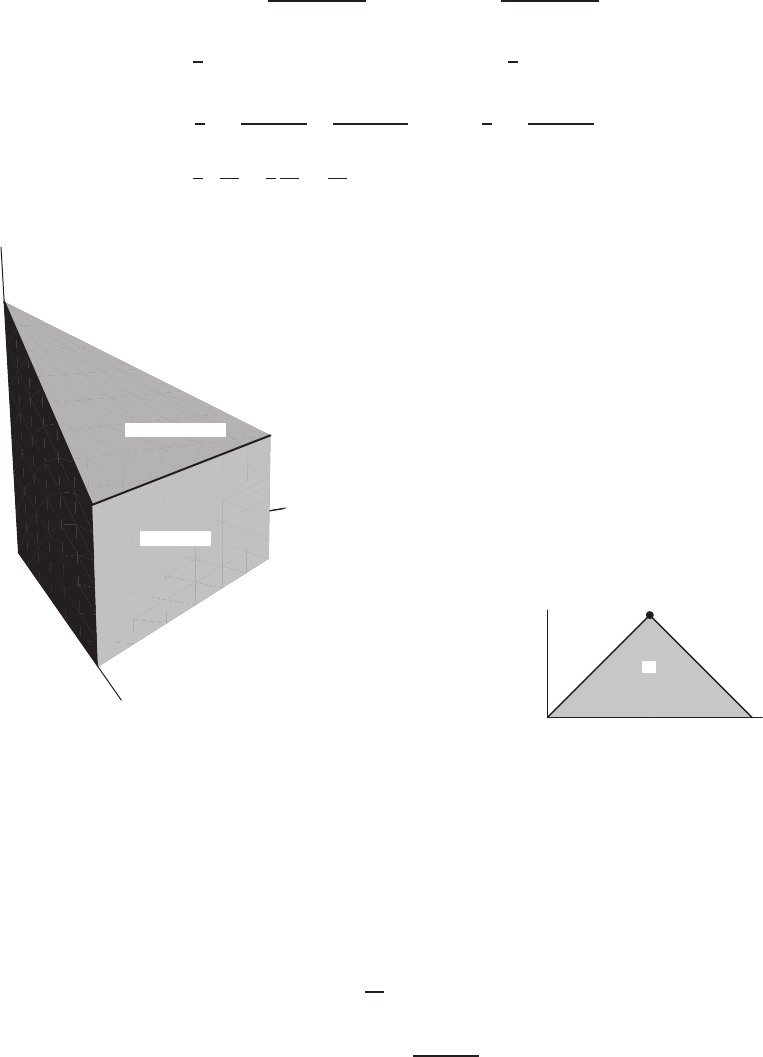
1506 Chapter Sixteen /SOLUTIONS
(b) Evaluating gives
Mass = Z1/2
0Zx
0
2z2
2−x−y
0
dy dx +Z1
1/2Z1−x
0
2z2
2−x−y
0
dy dx
= 2 Z1/2
0Zx
0
(2−x−y)2dy dx + 2 Z1
1/2Z1−x
0
(2 −x−y)2dy dx
= 2 Z1/2
0−(2 −x−y)3
3
x
0
dx + 2 Z1
1/2−(2 −x−y)3
3
1−x
0
dx
=2
3Z1/2
0(2 −x)3−(2 −x−x)3dx +2
3Z1
1/2(2 −x)3−13dx
=2
3−(2 −x)4
4+8(1 −x)4
4
1/2
0
+2
3−(2 −x)4
4−x
1
1/2
=2
3·55
64 +2
3
33
64 =88
96 .
x+y+z= 2
x+y= 1
x
y
z
Figure 16.64
: The solid
y=x x +y= 1
(1/2,1/2)
R
x
y
Figure 16.65
: Base of solid
49. The region looks like an upside-down trough, with cross section in the xz-plane shown in Figure 16.66, extending a
distance of 3cm in the y-direction.
Since the region and the density function are symmetric about the z-axis, we find the mass of the right side and
double it. In grams
Mass = 2 Z3
0Z1
0Z1−x
0
(10 −z)dz dx dy
= 2 Z3
0Z1
010z−z2
2
1−x
0
dx dy
= 2 Z3
0Z1
010(1 −x)−(1 −x)2
2dx dy

16.3 SOLUTIONS 1507
=Z3
0Z1
0
(19 −18x−x2)dx dy
= 3 ·19x−9x2−x3
3
1
0
=319 −9−1
3= 29 gm.
−1 1
1
z= 1 + x z = 1 −x
x
z
Figure 16.66
50. The region of integration is shown in Figure 16.67, and the mass of the given solid is given by
x
y
z
3
2
6
x
3+y
2+z
6= 1
or
z=−2x−3y+ 6
✛x
3+y
2= 1
or
y=−2
3x+ 2
Figure 16.67
mass = ZR
δ dV
=Z3
0Z−2
3x+2
0Z−2x−3y+6
0
(x+y)dz dy dx
=Z3
0Z−2
3x+2
0
(x+y)z
−2x−3y+6
0
dydx
=Z3
0Z−2
3x+2
0
(x+y)(−2x−3y+ 6) dydx
=Z3
0Z−2
3x+2
0
(−2x2−3y2−5xy + 6x+ 6y)dydx
=Z3
0−2x2y−y3−5
2xy2+ 6xy + 3y2
−2
3x+2
0
dx
=Z3
014
27 x3−8
3x2+ 2x+ 4dx
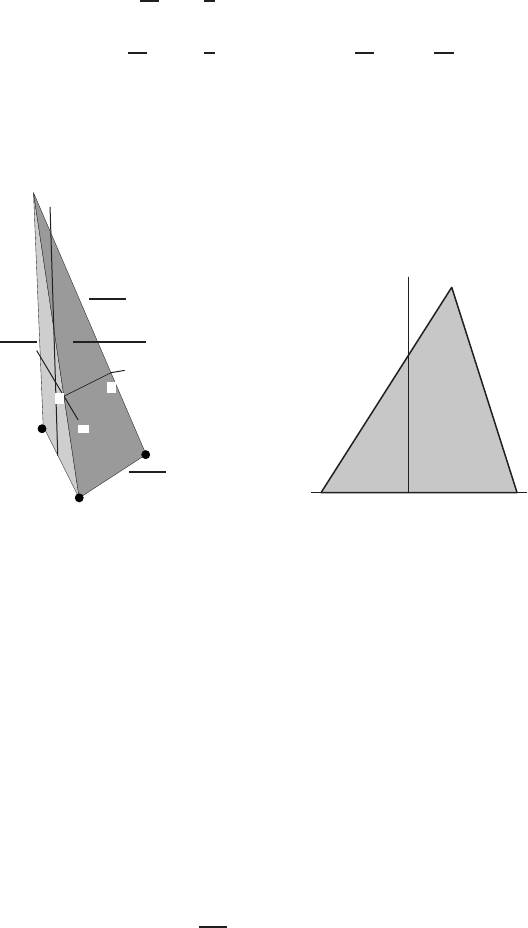
1508 Chapter Sixteen /SOLUTIONS
=7
54 x4−8
9x3+x2+ 4x
3
0
=7
54 ·34−8
9·33+ 32+ 12 = 21
2−3 = 15
2.
51. The pyramid is shown in Figure 16.68. The planes y= 0, and y−x= 4, and 2x+y+z= 4 intersect the plane z=−6
in the lines y= 0,y−x= 4,2x+y= 10 as shown in Figure 16.69.
x
y
z
2
−4
4
✛2x+y+z= 4
✲
y= 0
✛z=−6
bottom
✛y−x= 4
backside
(−4,0,−6)
(5,0,−6)
(2,6,−6)
Figure 16.68
(−4,0,−6) (5,0,−6)
(2,6,−6)
z=−6
plane
x
y
y−x= 4 2x+y−6 = 4
Figure 16.69
These three lines (the edges of the pyramid) intersect the plane z=−6at the points (−4,0,−6),(5,0,−6), and
(2,6,−6). Let Rbe the triangle in the plane z=−6with these three points as vertices. Then, the mass of the solid is
Mass =Z6
0Z(10−y)/2
y−4Z4−2x−y
−6
δ(x, y, z)dz dx dy
=Z6
0Z(10−y)/2
y−4Z4−2x−y
−6
ydz dx dy
=Z6
0Z(10−y)/2
y−4
y(10 −2x−y)dx dy
=Z6
0
y(10x−x2−xy)
x=(10−y)/2
x=y−4
dy
=Z6
0
(9y3
4−27y2+ 81y)dy
= 243.
52. (a) Since δ(x, y, z) = zis measured in grams per cm3,and since volume is measured in cm3,the integral represents the
mass of the pyramid, in grams.
(b) The pyramid is bounded below by the plane z= 0 and is bounded above by the four planes z= 6 −x, z = 6 −y,
z=x, and z=y. Therefore, since there are four different surfaces bounding the pyramid on the top, we would need
four separate triple integrals.
(c) We integrate in the y-direction first. The pyramid is bounded on the left and right sides by the planes y−z= 0 and
y+z= 6,so our ylimits of integration are y=zand y= 6 −z. After projecting into the xz-plane, we obtain the
region bounded by the lines z=x, z = 6 −x, and z= 0,as shown in Figure 16.70:

16.3 SOLUTIONS 1509
3 6
3
x
z
Figure 16.70
Therefore, if we integrate in the xdirection next, our limits are x=zand x= 6 −z, so we have
ZE
zdV =Z3
0Z6−z
zZ6−z
z
zdy dx dz =Z3
0Z6−z
z
zy
6−z
z
dx dz
=Z3
0Z6−z
z
z(6−2z)dxdz =Z3
0
z(6 −2z)x
6−z
z
dz =Z3
0
z(6 −2z)2dz
=Z3
0
(36z−24z2+ 4z3)dz = (18z2−8z3+z4)
3
0
= 27,
and we conclude that the mass of the pyramid is 27 grams.
53. (a) The vectors ~u =~
i−~
jand ~v =~
i−~
klie in the required plane so ~p =~u ×~v =~
i+~
j+~
kis perpendicular
to this plane. Let (x, y, z)be a point in the plane, then (x−1)
~
i+y~
j+z~
kis perpendicular to ~p , so ((x−1)
~
i+
y~
j+z~
k)·(
~
i+~
j+~
j) = 0 and so
(x−1) + y+z= 0.
Therefore, the equation of the required plane is x+y+z= 1.
(b) The required volume, V, is given by
V=Z1
0Z1−x
0Z1−x−y
0
dz dy dx
=Z1
0Z1−x
0
(1−x−y)dy dx
=Z1
0
y−xy −1
2y2
1−x
0
dx
=Z1
01−x−x(1−x)−1
2(1 −x)2dx
=Z1
0
1
2(1 −x)2dx
=1
6.
54. We will integrate in the z-direction first. Observe that the bottom of Eis given by the plane z= 0,and the top of Eis
given by the plane z= 4 −2x−4y. After projecting Einto the xy-plane, we obtain the region bounded by the lines
3x−2y= 0,2x+ 4y= 4,and y= 0 (see Figure 16.71).

1510 Chapter Sixteen /SOLUTIONS
1
22
3
4
x
y
Figure 16.71
We can see from the picture that, if we integrate in the x-direction next, our limits of integration will be x= (2/3)y
and x= 2 −2y. Therefore, our final answer is
Z3/4
0Z2−2y
2y
3Z4−2x−4y
0
f(x, y, z)dz dx dy.
55. We will integrate in the x-direction first. Observe that the “back” side of Eis given by the plane x= 0,and the “front”
side of Eis given by the plane x= 2 −2y−(1/2)z. After projecting Einto the yz-plane, we obtain the region bounded
by the lines y= 0, z = 0, z = 2,and 4y+z= 4 (see Figure 16.72).
1
21
2
x
y
Figure 16.72
We can see from the picture that, if we integrate in the y-direction next, our limits of integration will be y= 0 and
x= 1 −(1/4)z. Therefore, our final answer is
Z2
0Z1−z
4
0Z2−2y−z
2
0
f(x, y, z)dx dy dz.
56. We will integrate in the y-direction first. Observe that the “left” side of Eis given by the plane 3x−2y= 0,and the
“right” side of Eis given by the plane 2x+4y+z= 4.Solving these equations for ygives us a lower limit of y= (3/2)x
and an upper limit of y= 1 −(1/2)x−(1/4)z. After projecting Einto the xz-plane, we obtain the region shown in
Figure 16.73.
1
2
4
x
y
Figure 16.73

16.3 SOLUTIONS 1511
We note that the xand the zintercepts in the picture can be determined by observing that the slanted boundary of
the projected region is given by the line of intersection of the planes y= (3/2)xand 2x+ 4y+z= 4.Substituting
y= (3/2)xinto 2x+ 4y+z= 4 yields the following:
2x+ 4 3x
2+z= 4
2x+ 6x+z= 4
8x+z= 4
Therefore, the projected region is bounded by the lines x= 0, z = 0,and 8x+z= 4 in the xz-plane, and so our final
answer is Z1
2
0Z4−8x
0Z1−x
2−z
4
3x
2
f(x, y, z)dy dz dx.
57. Orient the region as shown in Figure 16.74 and use Cartesian coordinates with origin at the center of the sphere. The
equation of the sphere is x2+y2+z2= 25, and we want the volume between the planes z= 3 and z= 5. The plane
z= 3 cuts the sphere in the circle x2+y2+ 32= 25, or x2+y2= 16.
Volume =Z4
−4Z√16−x2
−√16−x2Z√25−x2−y2
3
dz dy dx.
x
y
z
5✠
Sphere is
x2+y2+z2= 25
■x2+y2= 16
■
Circle is
x2+y2= 16
✻
❄
3
✻
❄
2
Figure 16.74
58. (a) The equation of the surface of the whole cylinder along the y-axis is x2+z2= 1. The part we want is
z=p1−x20≤y≤10.
See Figure 16.75.
x1
y
10
z
Figure 16.75
(b) The integral is
ZD
f(x, y, z)dV =Z10
0Z1
−1Z√1−x2
0
f(x, y, z)dz dx dy.
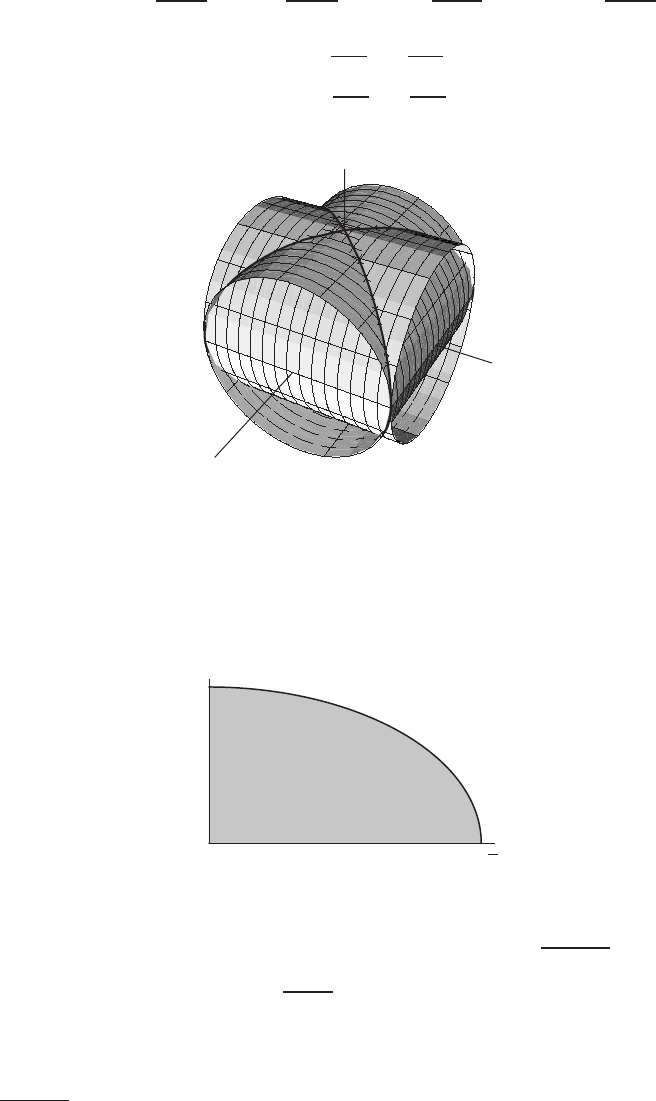
1512 Chapter Sixteen /SOLUTIONS
59. The intersection of two cylinders x2+z2= 1 and y2+z2= 1 is shown in Figure 16.76. This region is bounded by four
surfaces:
z=−p1−x2, z =p1−x2, y =−p1−z2,and y=p1−z2
So the volume of the given solid is
V=Z1
−1Z√1−x2
−√1−x2Z√1−z2
−√1−z2
dy dz dx
x
y
z
Figure 16.76
60. Integrating in the z-direction first, our lower limit is the plane z= 0,and the upper limit is the surface z= 6y2.After
projecting Einto the xy-plane, we obtain the region in the first quadrant that lies inside the ellipse x2+ 3y2= 12 (see
Figure 16.77).
2√3
2
x
y
Figure 16.77
Therefore, our x-limits of integration are the line x= 0 and the ellipse x=p12 −3y2,so our answer is
Z2
0Z√12−3y2
0Z6y2
0
f(x, y, z)dz dx dy.
61. Integrating in the x-direction first, our lower limit of integration is the plane x= 0,and the upper limit is the cylinder
x=p12 −3y2.After projecting Einto the yz-plane, we obtain the two-dimensional region bounded between the
curves z= 0, y = 2,and z= 6y2.Substituting y= 2 into z= 6y2gives z= 24,which is the zcoordinate of the point
of intersection of the two curves (see Figure 16.78).
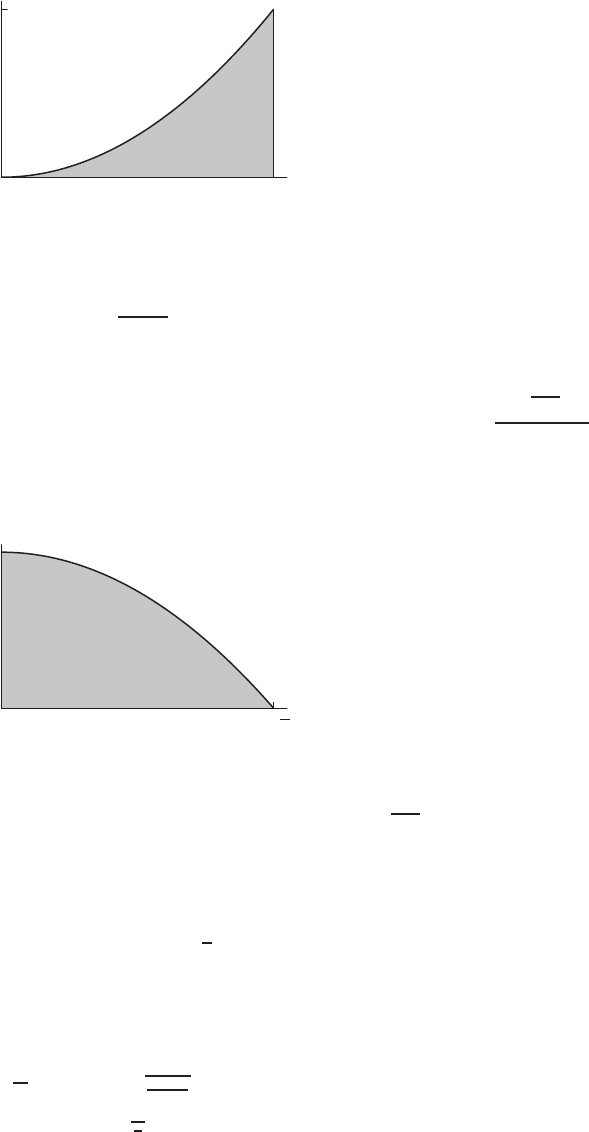
16.3 SOLUTIONS 1513
2
24
x
y
Figure 16.78
Therefore, our final answer is
Z2
0Z6y2
0Z√12−3y2
0
f(x, y, z)dx dz dy.
62. Integrating in the y-direction first, one bounding surface isz= 6y2,which, after solving for y, becomes y=pz/6,our
lower limit of integration. Similarly, the other bounding surface isx2+ 3y2= 12,which becomes y=p(12 −x2)/3,
our upper limit. After projecting Einto the xz-plane, we obtain a region bounded by two line segments and a curve (see
Figure 16.79).
2√3
24
x
y
Figure 16.79
We can find the equation of the curve by finding the intersection of the cylinders y=pz/6and x2+ 3y2= 12 and
projecting into the xz-plane:
12 = x2+ 3y2
12 = x2+ 3 z
6
24 = 2x2+z
z= 24 −2x2
Therefore, our z-limits of integration are the line z= 0 and the parabola z= 24 −2x2,and so our final answer is
Z√12
0Z24−2x2
0Zp12−x2
3
√z
6
f(x, y, z)dy dz dx.
63. From the problem, we know that (x, y, z)is in the cube which is bounded by the three coordinate planes, x= 0,y= 0,
z= 0 and the planes x= 2,y= 2,z= 2. We can regard the value x2+y2+z2as the density of the cube. The average
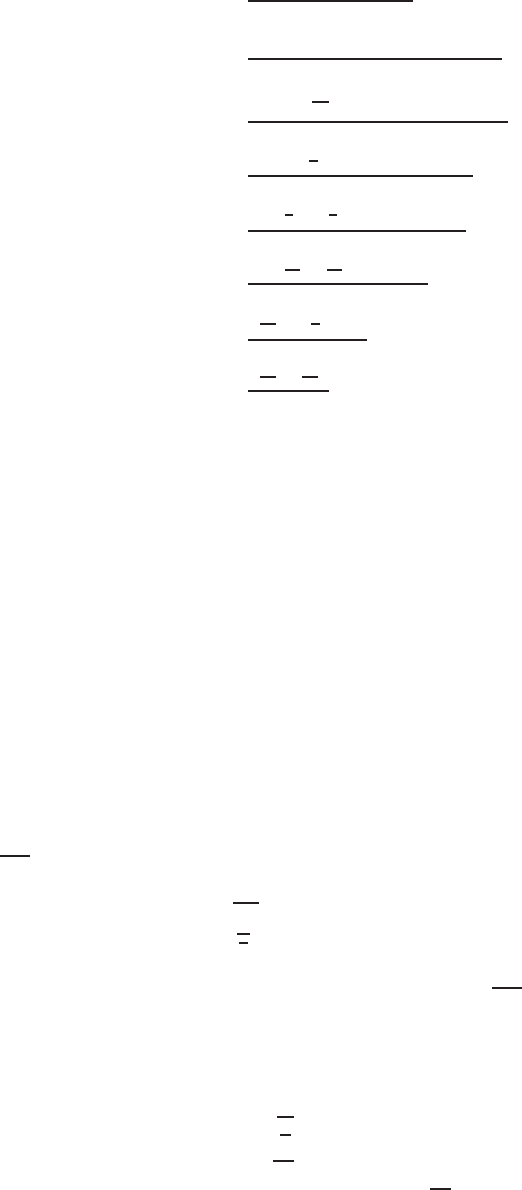
1514 Chapter Sixteen /SOLUTIONS
value of x2+y2+z2is given by
average value =RV(x2+y2+z2)dV
volume(V)
=R2
0R2
0R2
0(x2+y2+z2)dx dy dz
8
=R2
0R2
0x3
3+ (y2+z2)x2
0dydz
8
=R2
0R2
08
3+ 2y2+ 2z2dydz
8
=R2
08
3y+2
3y3+ 2z2y2
0dz
8
=R2
016
3+16
3+ 4z2dz
8
=32
3z+4
3z32
0
8
=64
3+32
3
8= 4.
64. As an aid in finding limits of integration, we begin by finding the coordinates of the four points highlighted on the
diagram. Clearly, one of them is the origin (0,0,0).The point at the top of Eis formed by the intersection of the plane
x+ 2y+z= 4 with the z-axis, so we substitute x= 0 and y= 0 into the equation of the plane to obtain z= 4,yielding
a point with coordinates (0,0,4).Similarly, the intersection of the plane x+ 2y+z= 4 with the y-axis produces a
point with coordinates (0,2,0).Finally, the last point highlighted on the diagram occurs at the intersection of the surfaces
x+ 2y+z= 4, x = 2y2,and z= 0.Substituting z= 0 and x= 2y2into the equation x+ 2y+z= 4 yields
2y2+ 2y= 4
y2+y−2 = 0
(y+ 2)(y−1) = 0
Since the desired point is in the first octant, its y-coordinate must be y= 1,which yields x= 2y2= 2,and we see that
the coordinates of the point are given by (2,1,0).
(a) Integrating in the z-direction first, our region is bounded by the plane z= 0 on the bottom and the plane x+2y+z= 4
on the top. Solving for ztherefore yields a lower limit of z= 0 and an upper limit of z= 4−x−2y. After projecting
Einto the xy-plane, we obtain the picture in Figure 16.80.
The curve at the top of this projected region is formed by the intersection of the plane x+2y+z= 4 and z= 0,
yielding an equation of x+ 2y= 4,or y= (4 −x)/2.The curve at the bottom of the projected region is simply the
portion of the cylinder x= 2y2that lies in the xy-plane. Therefore, our y-limits of integration are y= (4 −x)/2
and y=px/2,yielding a final answer of
Z2
0Z4−x
2
√x
2Z4−x−2y
0
f(x, y, z)dz dy dx.
(b) Integrating in the y-direction first, our region is bounded by the parabolic cylinder x= 2y2on one side and the plane
x+ 2y+z= 4 on the other side. Solving these equations for yyields y=px/2and y= (4 −x−z)/2as our
y-limits of integration. After projecting Einto the xz-plane, we obtain the picture in Figure 16.81.
We can find the equation of the curve bounding the top of the projected region by finding the intersection of the
surfaces x= 2y2and x+ 2y+z= 4 and projecting into the xz-plane:
x+ 2y+z= 4
x+ 2qx
2+z= 4
x+√2x+z= 4
z= 4 −x−√2x
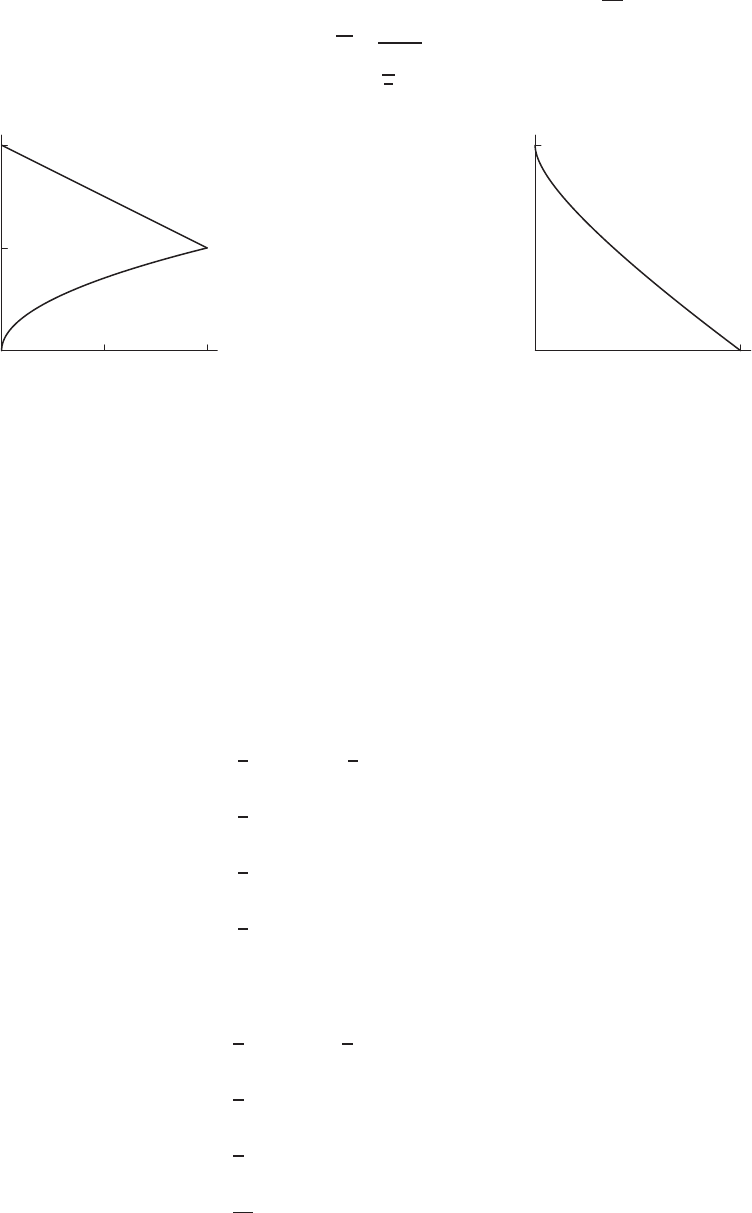
16.3 SOLUTIONS 1515
Therefore, our z-limits of integration are the line z= 0 and the curve z= 4 −x−√2x, and so our final answer is
Z2
0Z4−x−√2x
0Z4−x−z
2
√x
2
f(x, y, z)dy dz dx.
1 2
1
2
x
y
Figure 16.80
2
4
x
z
Figure 16.81
65. The mass mis given by
m=ZW
1dV=Z1
0Z1
0Zx+y+1
0
1dz dy dx
=Z1
0Z1
0
(x+y+ 1) dy dx
=Z1
0xy +y2/2+y)1
0dx
=Z1
0
(x+3/2) dx = 2 gm.
Then the x-coordinate of the center of mass is given by
¯x=1
2ZW
x dV =1
2Z1
0Z1
0Zx+y+1
0
x dz dy dx
=1
2Z1
0Z1
0
x(x+y+ 1) dy dx
=1
2Z1
0x2y+xy2/2 + xy)1
0dx
=1
2Z1
0
(x2+ 3/2x)dx = 13/24 cm.
An essentially identical calculation (since the region is symmetric in xand y) gives ¯y= 13/24 cm.
Finally, we compute ¯z:
¯z=1
2ZW
z dV =1
2Z1
0Z1
0Zx+y+1
0
z dz dy dx
=1
2Z1
0Z1
0
(x+y+ 1)2/2dy dx
=1
2Z1
0
(x+y+1)3/61
0dx
=1
12 Z1
0
((x+ 2)3−(x+ 1)3)dx = 25/24 cm.
So (¯x, ¯y, ¯z) = (13/24,13/24,25/24).

1516 Chapter Sixteen /SOLUTIONS
66. The mass mis given by
m=ZW
1dV=Z1
0Z(1−x)/2
0Z(1−x−2y)/3
0
1dz dy dx
=Z1
0Z(1−x)/2
0
1−x−2y
3dy dx
=1
3Z1
0
(y−xy −y2)
(1−x)/2
0
dx
=1
3Z1
0
1−x
2−x1−x
2−1−x
22dx
=1
3Z1
0(1 −x)2
2−(1 −x)2
4dx
=1
3(1 −x)3
12
1
0
=1/36 gm.
Then the coordinates of the center of mass are given by
¯x= 36 ZW
xdV = 36 Z1
0Z(1−x)/2
0Z(1−x−2y)/3
0
xdz dy dx = 1/4cm.
and
¯y= 36 ZW
ydV = 36 Z1
0Z(1−x)/2
0Z(1−x−2y)/3
0
y dz dy dx = 1/8cm.
and
¯z= 36 ZW
zdV = 36 Z1
0Z(1−x)/2
0Z(1−x−2y)/3
0
zdz dy dx = 1/12 cm.
67. The volume Vof the solid is 1·2·3 = 6. We need to compute
m
6ZW
x2+y2dV =m
6Z1
0Z2
0Z3
0
x2+y2dz dy dx
=m
6Z1
0Z2
0
3(x2+y2)dy dx
=m
2Z1
0
(x2y+y3/3)2
0dx
=m
2Z1
0
(2x2+ 8/3) dx = 5m/3
68. The volume of the solid is 8abc, so we need to evaluate
m
8abc ZW
(y2+z2)dV =m
8abc Zc
−cZb
−bZa
−a
(y2+z2)dx dy dz
=m
8abc Zc
−cZb
−b
2a(y2+z2)dy dz
=m
4bc Zc
−c
(y3/3 + yz2)b
−bdz
=m
2cZc
−c
(b2/3 + z2)dz
=m(b2+c2)/3
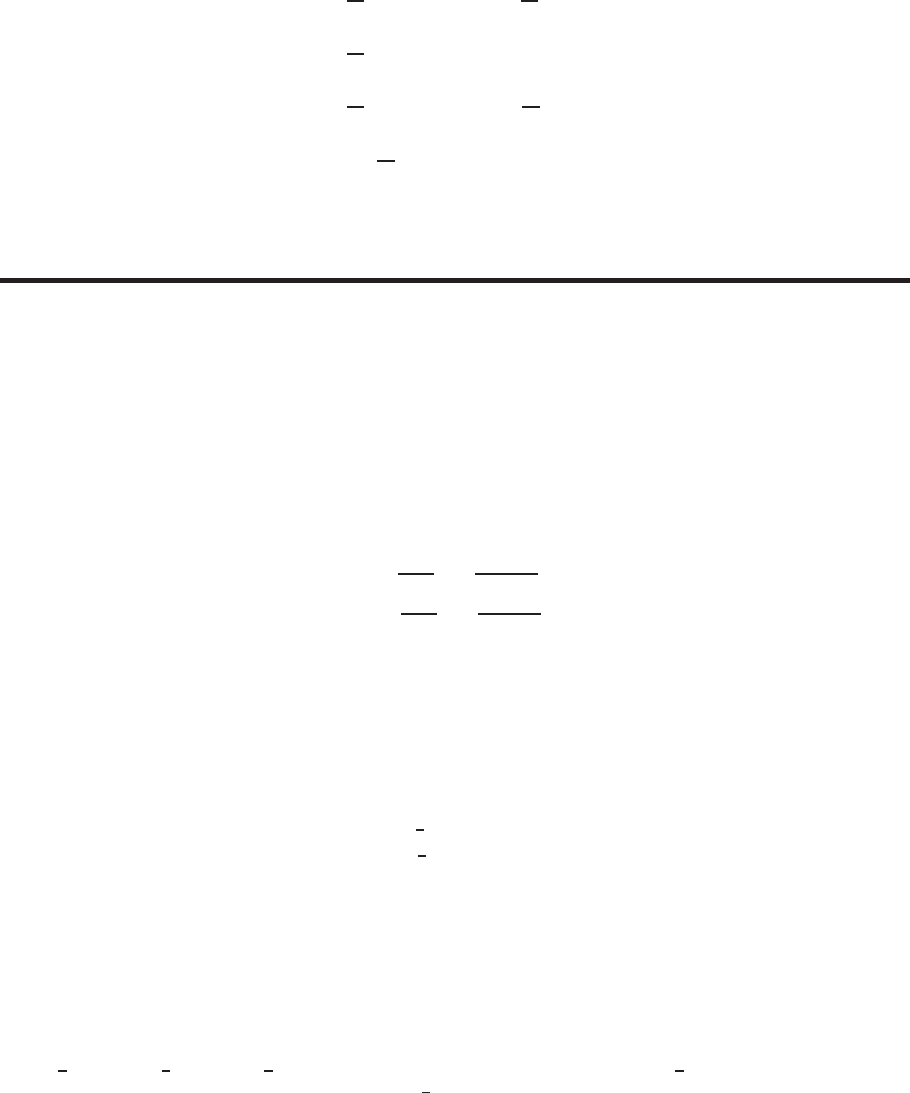
16.3 SOLUTIONS 1517
69. By the definition, we have that
a+b=m
VZW
(y2+z2)dV +m
VZW
(x2+z2)dV
=m
VZW
(x2+y2+ 2z2)dV
=m
VZW
(x2+y2)dV +m
VZW
(2z2)dV
=c+m
VZW
(2z2)dV
Since z2is always positive, the integral RW(2z2)dV will be positive, thus a+b > c.
Strengthen Your Understanding
70. This would be true if the function fwere even in z; that is, if f(x, y, −z) = f(x, y, z), so that the integral over the lower
half of the sphere and the upper half of the sphere were equal. But if f(x, y, z) = z, then RSf(x, y, z)dV = 0 while
RUf(x, y, z)dV is positive.
71. The limits for the innermost integrals should be the same since both integrate first with respect to z.
72. The volume of Ris π·22·3 = 12π, so we choose fto be the constant function f(x, y, z) = 7/(12π).
73. Since fis not constant, the integral over different parts of the spherical region must cancel. For example, if we take
f(x, y, z) = z, the integral over the top and bottom halves of the region cancel. Many other answers are possible.
74. False. The integral gives the total mass of the material contained in W.
75. True. The region lies above the square 0≤x≤1,0≤y≤1and below the plane z=x.
76. False. The given limits only cover the part of the unit ball in the first octant where x≥0, y ≥0,and z≥0. To cover the
entire unit ball the limits are
Z1
−1Z√1−x2
−√1−x2Z√1−x2−y2
−√1−x2−y2
f dzdydx.
77. True. Both sets of limits describe the solid region lying above the triangle x+y≤1, x ≥0, y ≥0, z = 0 and below the
plane x+y+z= 1.
78. True. Both sets of limits describe the solid region lying above the rectangle −1≤x≤1,0≤y≤1, z = 0 and below
the parabolic cylinder z= 1 −x2.
79. False. The iterated integral is of the form like Rb
aRd
cRk
efdz dy dx only if the rectangular region has faces parallel to the
coordinate axes. More general rectangular regions, such as a cube with one corner at the origin and the opposite corner at
(0,0,1) will need to be written as the sum of iterated integrals where the limits are not constant.
80. False. As a counterexample, consider f(x, y, z) = 1
2−x. Then fis positive on half the cube and negative on the other
half. Symmetry can be used to show that R1
0R1
0R1
0(1
2−x)dz dy dx = 0.
81. True. Since RWf dV = lim X
i,j,k
f(xi, yj, zk)∆V, where (xi, yj, zk)is a point inside the ijk-th sub-box of volume ∆V,
and since f > g, we have
lim X
i,j,k
f(xi,yj, zk)∆V > lim X
i,j,k
g(xi, yj, zk)∆V=ZW
g dV.
82. False. As a counterexample, let W1be the solid cube 0≤x≤1,0≤y≤1,0≤z≤1,and let W2be the solid cube
−1
2≤x≤0,−1
2≤y≤0,−1
2≤z≤0.Then volume(W1) = 1 and volume(W2) = 1
8.Now if f(x, y, z) = −1,then
RW1f dV =1· −1which is less than RW2f dV =1
8· −1.
83. True. If Wis the solid region lying under the graph of fand above the region Rin the xy-plane, we can compute the
volume of Weither using the double integral RRf dA, or using the triple integral RW1dV.
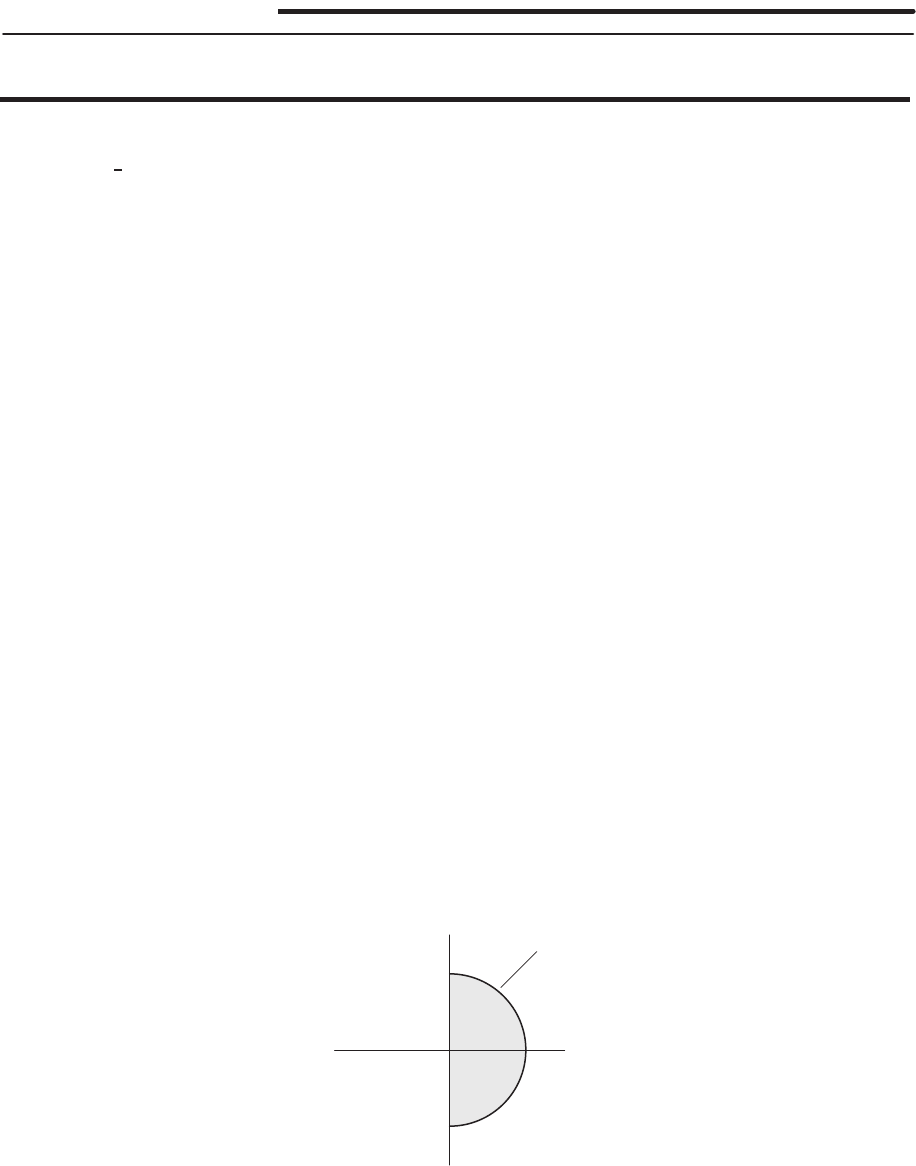
1518 Chapter Sixteen /SOLUTIONS
Solutions for Section 16.4
Exercises
1. Zπ/2
0Z1/2
0
f rdr dθ
2. Z2π
0Z√2
0
f rdr dθ
3. Z3π/4
π/4Z2
0
f rdr dθ
4. Z3π/2
π/2Z2
1
f rdr dθ
5. Since this is a rectangular region, we use Cartesian coordinates. The rectangle is described by the inequalities 1≤x≤5
and 2≤y≤4, so the integral is Z5
1Z4
2
f(x, y)dy dx.
6. A circle is best described in polar coordinates. The radius is 5, so rgoes from 0 to 5. To include the entire circle, we need
θto go from 0 to 2π. The integral is Z2π
0Z5
0
f(rcos θ, r sin θ)r dr dθ.
7. This is a portion of a circle so it is best described in polar coordinates. The region is a piece of a ring in which rgoes from
2 to 4. Since we include only the portion of the ring below the x-axis, we need θto go from πto 2π. The integral is
Z2π
πZ4
2
f(rcos θ, r sin θ)r dr dθ.
8. Since this is a triangular region we can use Cartesian coordinates. The bottom boundary of the triangle is the line y=x+1
and the top boundary is the line y= 5 −x. The xlimits are 0 to 2. The integral is
Z2
0Z5−x
x+1
f(x, y)dy dx.
9. See Figure 16.82.
x
y
θ=−π/2
θ=π/2✠
r= 4
Figure 16.82

16.4 SOLUTIONS 1519
10. See Figure 16.83.
−1
1
x
y
❘
r= 1
Figure 16.83
11. See Figure 16.84.
1 2 x
y
✠
r= 2
✙
r= 1
Figure 16.84
12. See Figure 16.85.
x
y
θ=π/6
θ=π/3
r= 1
Figure 16.85
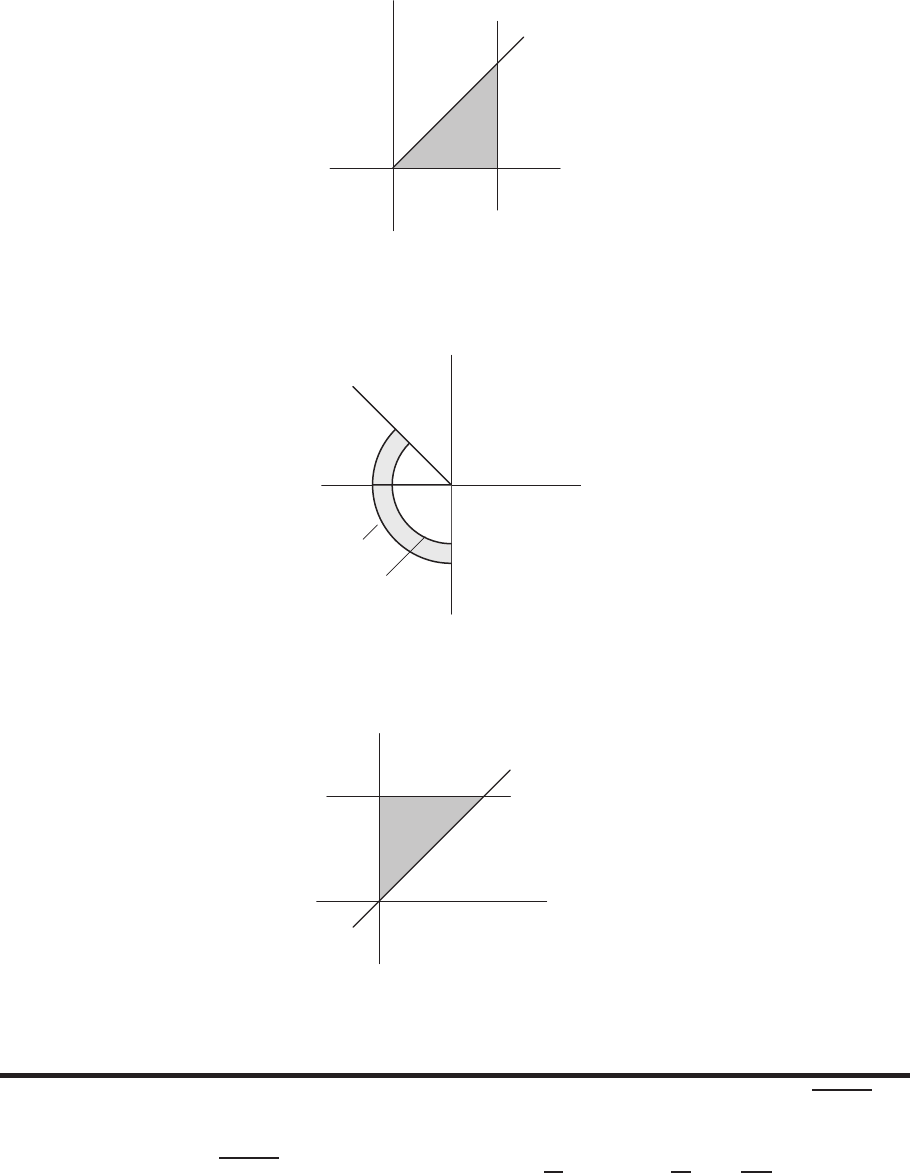
1520 Chapter Sixteen /SOLUTIONS
13. See Figure 16.86.
x
y
θ=π/4
r= 1/cos θ
or
rcos θ= 1
or
x= 1
Figure 16.86
14. See Figure 16.87.
x
y
θ= 3π/4
θ= 3π/2
✒
r= 4 ✒
r= 3
Figure 16.87
15. See Figure 16.88.
x
y
r= 2/sin θ
or
rsin θ= 2
or
y= 2
θ=π/4
Figure 16.88
Problems
16. The presence of the term x2+y2suggests that we should convert the integral into polar coordinates. Since px2+y2=r,
the integral becomes
ZRpx2+y2dxdy =Z2π
0Z3
2
r2drdθ =Z2π
0
r3
3
3
2
dθ =Z2π
0
19
3dθ =38π
3.
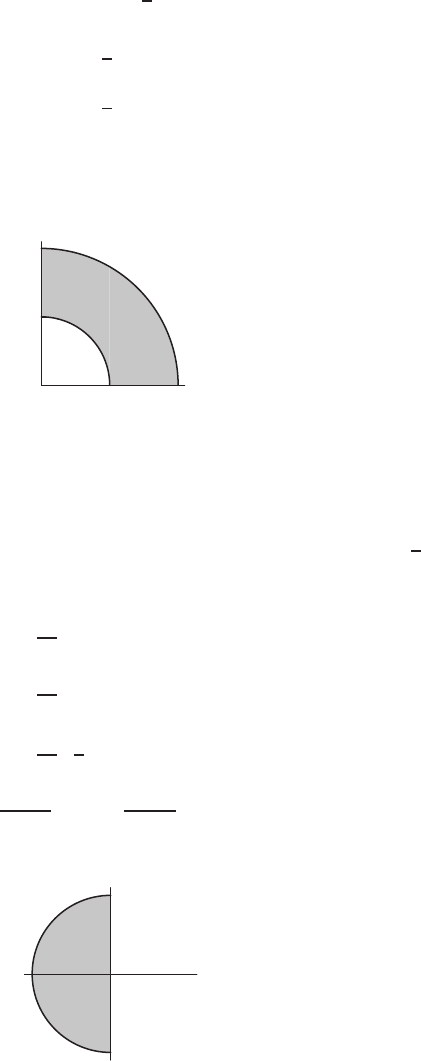
16.4 SOLUTIONS 1521
17. By using polar coordinates, we get
ZR
sin(x2+y2)dA =Z2π
0Z2
0
sin(r2)r dr dθ
=Z2π
0−1
2cos(r2)
2
0
dθ
=−1
2Z2π
0
(cos 4 −cos 0) dθ
=−1
2(cos 4 −1) ·2π=π(1 −cos 4)
18. The region is pictured in Figure 16.89.
1 2
1
2
x
y
Figure 16.89
Using polar coordinates, we get
ZR
(x2−y2)dA=Zπ/2
0Z2
1
r2(cos2θ−sin2θ)rdr dθ =Zπ/2
0
(cos2θ−sin2θ)·1
4r4
2
1
dθ
=15
4Zπ/2
0
(cos2θ−sin2θ)dθ
=15
4Zπ/2
0
cos 2θ dθ
=15
4·1
2sin 2θ
π/2
0
=0.
19. By the given limits 0≤x≤ −1, and −√1−x2≤y≤√1−x2, the region of integration is in Figure 16.90.
x
y
−1
Figure 16.90
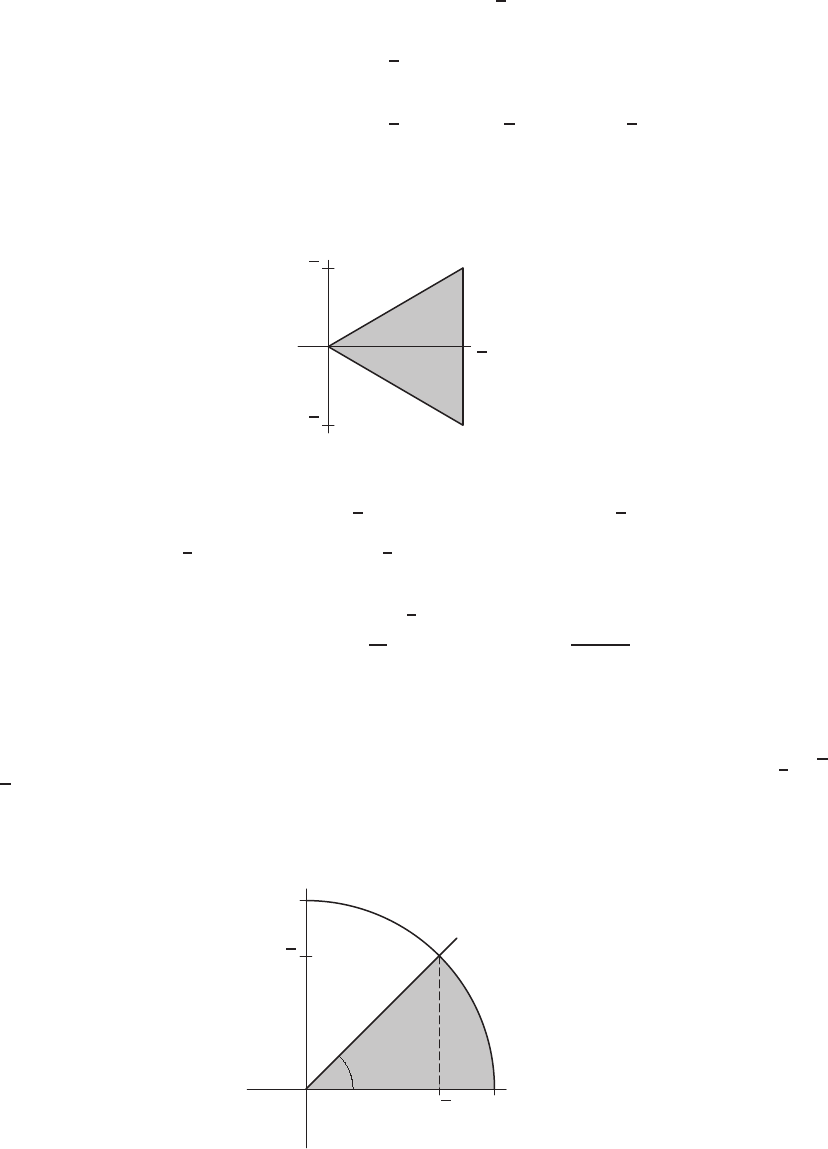
1522 Chapter Sixteen /SOLUTIONS
In polar coordinates, we have
Z3π/2
π/2Z1
0
rcos θ r dr dθ =Z3π/2
π/2
cos θ1
3r3
1
0
dθ
=1
3Z3π/2
π/2
cos θ dθ
=1
3sin θ
3π/2
π/2
=1
3(−1−1) = −2
3
20. From the given limits, the region of integration is in Figure 16.91.
−√6
√6
x
y
y=x
√6
y=−x
Figure 16.91
In polar coordinates, −π/4≤θ≤π/4. Also, √6 = x=rcos θ. Hence, 0≤r≤√6/cos θ. The integral becomes
Z√6
0Zx
−x
dy dx =Zπ/4
−π/4Z√6/cos θ
0
r dr dθ
=Zπ/4
−π/4 r2
2
√6/cos θ
0!dθ =Zπ/4
−π/4
6
2 cos2θdθ
= 3 tan θ
π/4
−π/4
= 3 ·(1 −(−1)) = 6.
Notice that we can check this answer because the integral gives the area of the shaded triangular region which is 1
2·√6·
(2√6) = 6.
21. From the given limits, the region of integration is in Figure 16.92.
2
x
y
√2
2
√2
x
y
π/4
x=y
Figure 16.92
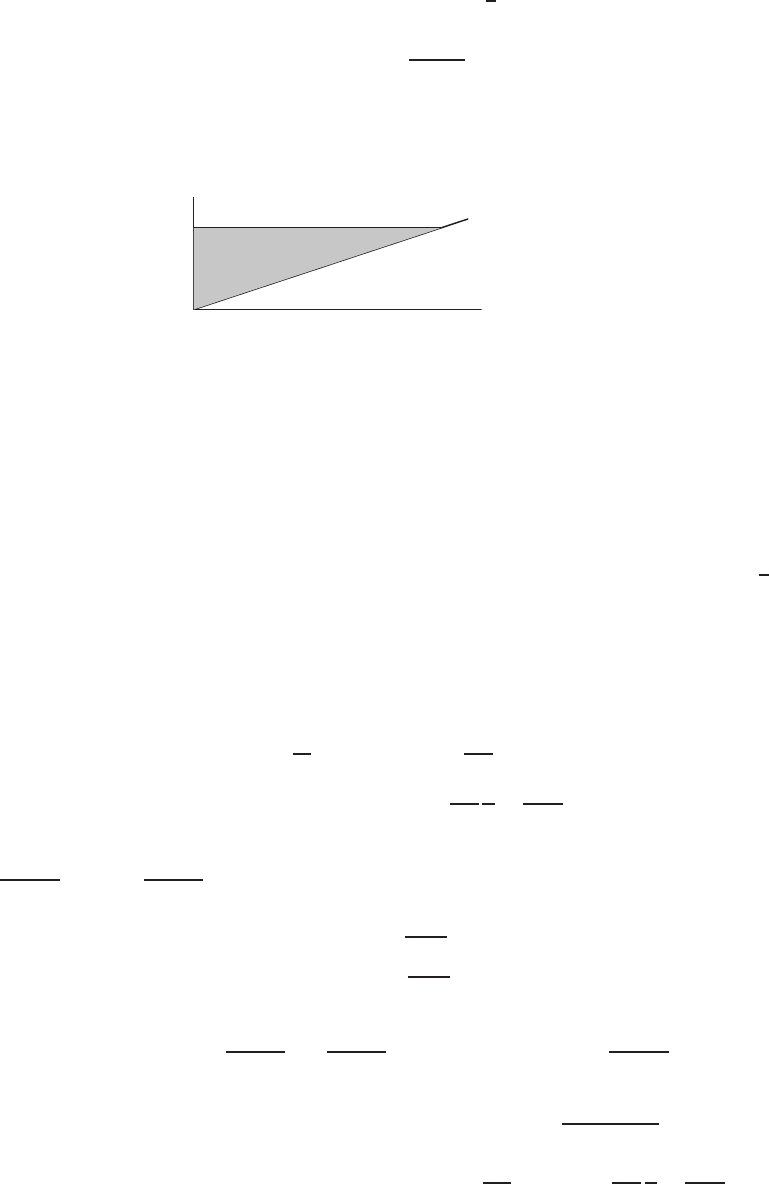
16.4 SOLUTIONS 1523
So, in polar coordinates, we have,
Zπ/4
0Z2
0
(r2cos θsin θ)r dr dθ =Zπ/4
0
cos θsin θ1
4r4
2
0
dθ
= 4 Zπ/4
0
sin(2θ)
2dθ
=−cos(2θ)
π/4
0
= 0 −(−1) = 1.
22. (a)
x
y
1
3
y=x/3
Figure 16.93
(b) Z1
0Z3y
0
f(x, y)dx dy.
(c) For polar coordinates, on the line y=x/3,tan θ=y/x = 1/3, so θ= tan−1(1/3). On the y-axis, θ=π/2. The
quantity rgoes from 0to the line y= 1, or rsin θ= 1, giving r= 1/sin θand f(x, y) = f(rcos θ, r sin θ). Thus
the integral is Zπ/2
tan−1(1/3)Z1/sin θ
0
f(rcos θ, r sin θ)r dr dθ.
23. (a) (i) The two planes contain the z-axis and form the sides of the orange wedge. Since x≥0, the plane y=x/√3
forms an angle of π/6radians with the y= 0 plane, hence 0≤θ≤π/6. We also have 0≤ρ≤5and
0≤φ≤π. Hence:
Volume =Zπ/6
0Zπ
0Z5
0
ρ2sin φ dρ dφ dθ.
Evaluating this integral, we get:
Volume =Zπ/6
0Zπ
0sin φ53
3−0dφ dθ =−125
3Zπ/6
0
(cos π−cos 0) dθ
=250
3
π
6=125π
9.
(ii) In cylindrical coordinates, the sphere is given by r2+z2= 25.
If we integrate first with respect to z, then zvaries between the top and bottom halves of the sphere, or
−√25 −r2≤z≤√25 −r2. Then, the shadow of the wedge over the xy-plane gives as a circular sector
where 0≤r≤5, and 0≤θ≤π/6. Hence:
Volume =Zπ/6
0Z5
0Z√25−r2
−√25−r2
r dz dr dθ.
Evaluating this integral, we get:
Volume =Zπ/6
0Z5
0rp25 −r2+p25 −r2dr dθ =Zπ/6
0Z5
02rp25 −r2dr dθ
=Zπ/6
0−(25 −r2)3/2
3/2
5
0
dθ
=250
3Zπ/6
0
dθ =250
3
π
6=125π
9.
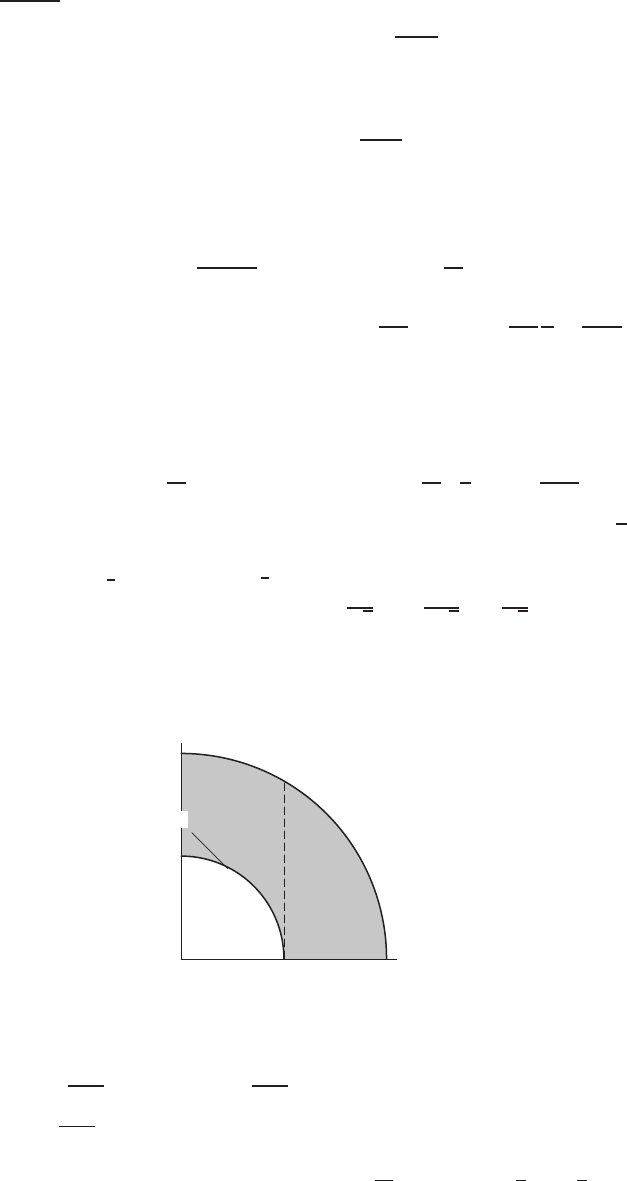
1524 Chapter Sixteen /SOLUTIONS
If we integrate first with respect to rand consider only the half of the wedge above the xy-plane then, for each
value of z,rvaries between zero and the radius of the horizontal cross section of the sphere at height z. Hence:
0≤r≤√25 −z2. We also have 0≤z≤5and 0≤θ≤π/6. This gives:
Volume half wedge =Zπ/6
0Z5
0Z√25−z2
0
r dr dz dθ,
for the top portion of the wedge, or for the full wedge
Volume = 2 Zπ/6
0Z5
0Z√25−z2
0
rdr dz dθ.
Evaluating the last integral, we get:
Volume = 2 Zπ/6
0Z5
025 −z2
2−0dz dθ =Zπ/6
0z3
3−25z
5
0
dθ
=250
3Zπ/6
0
dθ =250
3
π
6=125π
9.
Spherical coordinates provide the most efficient integration method for calculating the volume of the wedge.
This makes sense because the wedge is cut out by spherical fundamental surfaces, and hence, in these coordi-
nates, all integration endpoints are constant.
(b) Since the interior angle of the wedge is π/6, we need a total of 12 wedges to recover a full sphere of radius 5. Hence:
Volume of wedge =1
12 Volume of sphere of radius 5 =1
12 4
3π53=125π
9.
24. Since r= 2/cos θwe have x=rcos θ= 2.Since θranges from 0to π/6,yranges from 0to y=x/√3. Converting
to Cartesian coordinates we have
Z2
0Zx/√3
0
dy dx =Z2
0
y
x/√3
0
dx =Z2
0
x
√3dx =x2
2√3
2
0
=2
√3.
25. (a) The region (shaded) is between the circles x2+y2= 1 and x2+y2= 4; see Figure 16.94. The first integral is to
the left of the dashed line x= 1; the second integral is to the right of the dashed line.
1 2
1
2
x2+y2= 4
❘
x2+y2= 1
x
y
Figure 16.94
(b) Converting to polar coordinates, we find the quantity in part (a) is given by
Z1
0Z√4−x2
√1−x2
x dy dx +Z2
1Z√4−x2
0
xdy dx =Zπ/2
0Z2
1
rcos θ r dr dθ
=r3
3
2
1·sin θ
π/2
0
=7
3·1 = 7
3.
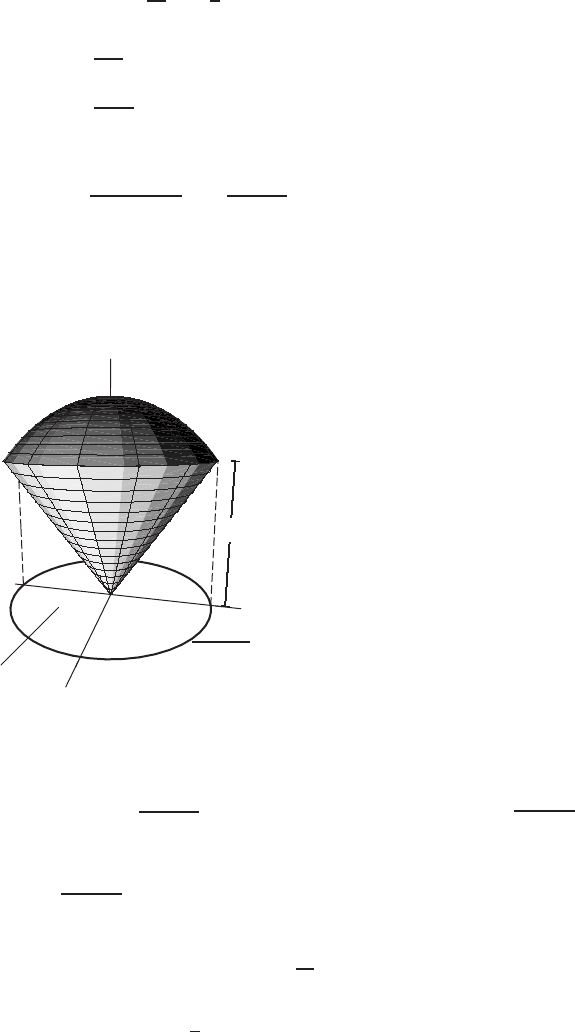
16.4 SOLUTIONS 1525
26. The graph of f(x, y) = 25−x2−y2is an upside down bowl, and the region whose volume we want is contained between
the bowl (above) and the xy-plane (below). We must first find the region in the xy-plane where f(x, y)is positive. To do
that, we set f(x, y)≥0and get x2+y2≤25. The disk x2+y2≤25 is the region Rover which we integrate.
Volume =ZR
(25 −x2−y2)dA =Z2π
0Z5
0
(25 −r2)rdr dθ
=Z2π
025
2r2−1
4r4
5
0
dθ
=625
4Z2π
0
dθ
=625π
2
27. First, let’s find where the two surfaces intersect.
p8−x2−y2=px2+y2
8−x2−y2=x2+y2
x2+y2= 4
So z= 2 at the intersection. See Figure 16.95.
x
y
z
✒
R
2
✛
✛
2
x2+y2= 4
✛
Figure 16.95
The volume of the ice cream cone has two parts. The first part (which is the volume of the cone) is the volume of the
solid bounded by the plane z= 2 and the cone z=px2+y2. Hence, this volume is given by ZR
(2 −px2+y2)dA,
where Ris the disk of radius 2 centered at the origin, in the xy-plane. Using polar coordinates, we have:
ZR2−px2+y2dA =Z2π
0Z2
0
(2 −r)·r dr dθ
=Z2π
0"r2−r3
3
2
0#dθ
=4
3Z2π
0
dθ
= 8π/3
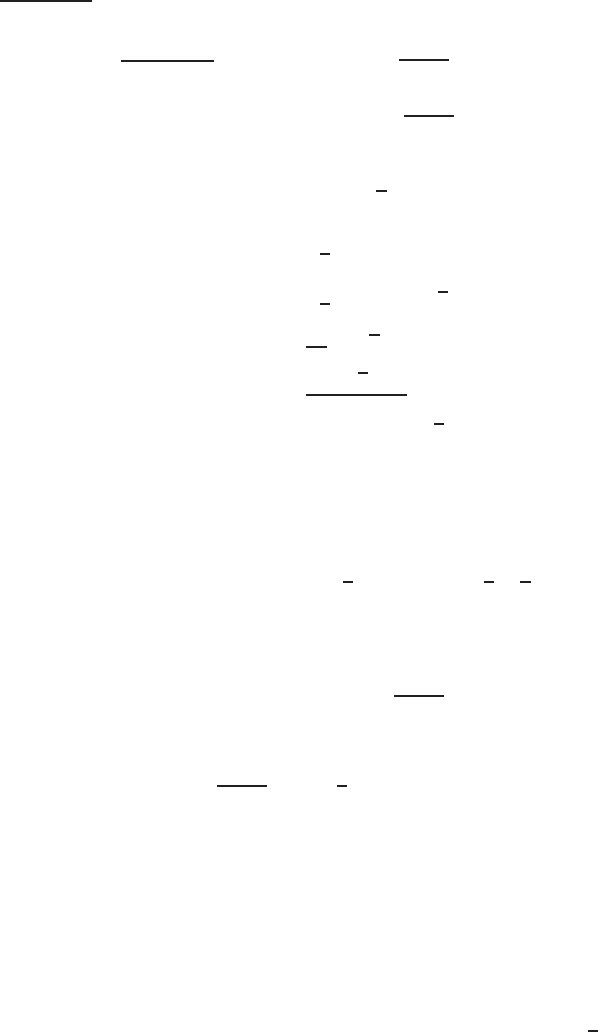
1526 Chapter Sixteen /SOLUTIONS
The second part is the volume of the region above the plane z= 2 but inside the sphere x2+y2+z2= 8, which is given
by ZR
(p8−x2−y2−2) dA where Ris the same disk as before. Now
ZR
(p8−x2−y2−2) dA =Z2π
0Z2
0
(p8−r2−2)rdr dθ
=Z2π
0Z2
0
rp8−r2dr dθ −Z2π
0Z2
0
2r dr dθ
=Z2π
0 −1
3(8 −r2)3/2
2
0!dθ −Z2π
0
r2
2
0
dθ
=−1
3Z2π
0
(43/2−83/2)dθ −Z2π
0
4dθ
=−1
3·2π(8 −16√2) −8π
=2π
3(16√2−8) −8π
=8π(4√2−5)
3
Thus, the total volume is the sum of the two volumes, which is 32π(√2−1)/3.
28. (a) The volume, V, is given by
V=Zx2+y2≤a2
e−(x2+y2)dA.
Converting to polar coordinates gives
V=Z2π
0Za
0
e−r2r dr dθ =θ
2π
0−1
2e−r2
a
0
=2π1
2−1
2e−a2=π(1 −e−a2).
(b) As a→ ∞, the value of e−a2→0, so the volume tends to π.
29. (a) Using polar coordinates, we have
Mass =Z2π
0Z3
0
1
r2+ 1 r dr dθ.
(b) Integrating with respect to θfirst
Mass = 2πZ3
0
r
r2+ 1 dr = 2π1
2ln |r2+ 1|
3
0
=π(ln 10 −ln 1) = πln 10.
30. (a)
Total Population =Z3π/2
π/2Z4
1
δ(r, θ)rdr dθ.
(b) We know that δ(r, θ)decreases as rincreases, so that eliminates (iii). We also know that δ(r, θ)decreases as the
x-coordinate decreases, but x=rcos θ. With a fixed r,xis proportional to cos θ. So as the x-coordinate decreases,
cos θdecreases and (i) δ(r, θ) = (4 −r)(2 + cos θ)best describes this situation.
(c)
Z3π/2
π/2Z4
1
(4 −r)(2 + cos θ)rdr dθ =Z3π/2
π/2
(2 + cos θ)(2r2−1
3r3)
4
1
dθ
= 9 Z3π/2
π/2
(2 + cos θ)dθ
= 92θ+sin θ3π/2
π/2
= 18(π−1) ≈39
Thus, the population is around 39,000.
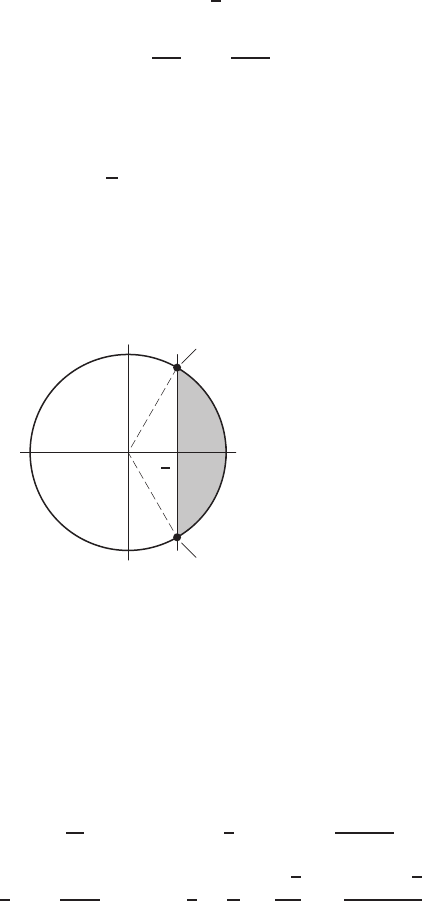
16.4 SOLUTIONS 1527
31. The density function is given by
ρ(r) = 10 −2r
where ris the distance from the center of the disk. So the mass of the disk in grams is
ZR
ρ(r)dA=Z2π
0Z5
0
(10 −2r)rdr dθ
=Z2π
05r2−2
3r35
0
dθ
=Z2π
0
125
3dθ =250π
3(grams)
32. The charge density is δ=k/r, where kis a constant.
Total charge =ZDisk
δdA =ZR
0Z2π
0
k
rr dθ dr =kZR
0Z2π
0
dθ dr =kZR
0
2π dr = 2kπR.
Thus the total charge is proportional to Rwith constant of proportionality 2kπ.
33. (a) The curve r= 1/(2 cos θ)or rcos θ= 1/2is the line x= 1/2. The curve r= 1 is the circle of radius 1 centered at
the origin. See Figure 16.96.
1
21
x= 1/2
✠θ=π/3
■θ=−π/3
x
y
Figure 16.96
(b) The line intersects the circle where 2 cos θ= 1, so θ=±π/3. From Figure 16.96 we see that
Area =Zπ/3
−π/3Z1
1/(2 cos θ)
r dr dθ.
Evaluating gives
Area =Zπ/3
−π/3 r2
2
1
1/(2 cos θ)!dθ =1
2Zπ/3
−π/31−1
4 cos2θdθ
=1
2θ−tan θ
4
π/3
−π/3
=1
22π
3−2√3
4=4π−3√3
12 .
34. (a) The circle r= 2 cos θhas radius 1 and is centered at (1,0); the circle r= 1 has radius 1 and is centered at the origin.
See Figure 16.97.
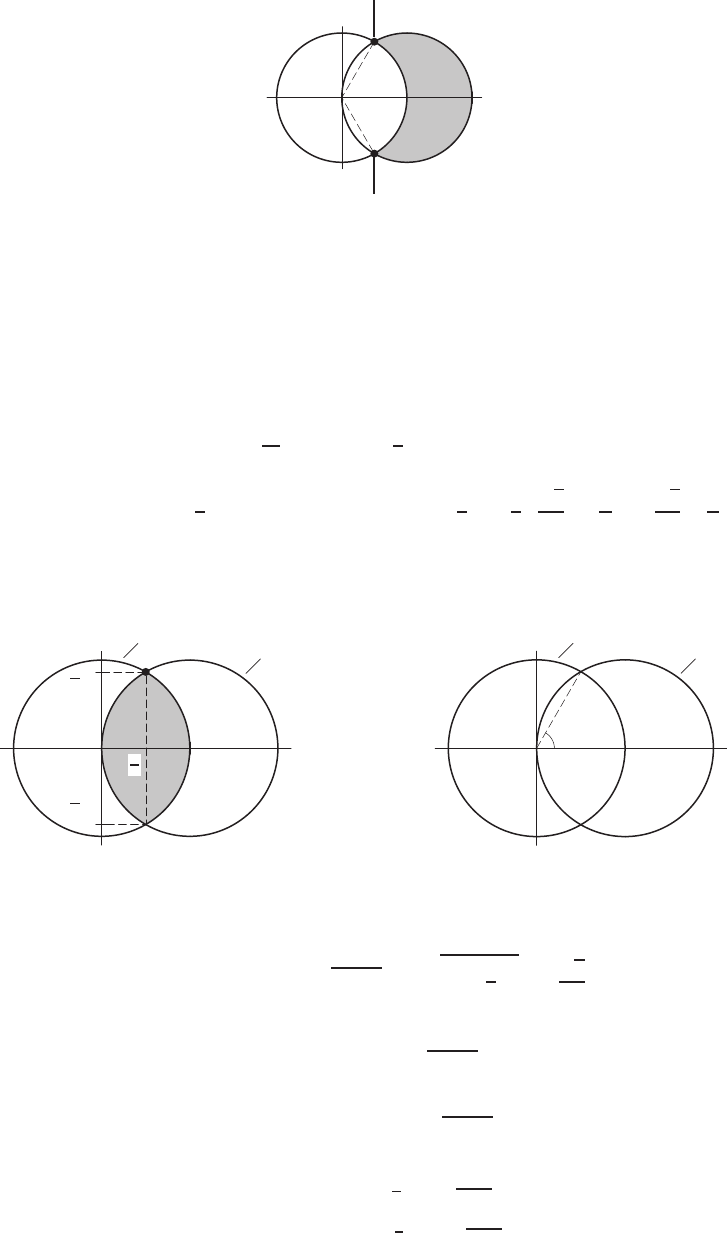
1528 Chapter Sixteen /SOLUTIONS
1 2
r= 2 cos θr = 1 ❄
θ=π/3
✻
θ=−π/3
x
y
Figure 16.97
(b) The circles intersect where 2 cos θ= 1, so θ=±π/3. From Figure 16.97 we see that
Area =Zπ/3
−π/3Z2 cos θ
1
r dr dθ.
Evaluating gives
Area =Zπ/3
−π/3 r2
2
2 cos θ
1!dθ =1
2Zπ/3
−π/34 cos2θ−1dθ
=1
2(2 cos θsin θ+ 2θ−θ)
π/3
−π/3
=1
24·1
2·√3
2+ 2 π
3=√3
2+π
3.
35. (a) We must first decide where to put the origin. We locate the origin at the center of one disk and locate the center of the
second disk at the point (1,0). See Figure 16.98. (Other choices of origin are possible.)
1
21
−√3/2
√3/2
✠x2+y2= 1
✠(x−1)2+y2= 1
x
y
Figure 16.98
π/3
✠r= 1
✠r= 2 cos θ
x
y
Figure 16.99
By symmetry, the points of intersection of the circles are half-way between the centers, at x= 1/2. The y-values
at these points are given by
y=±p1−x2=±r1−1
22
=±√3
2.
We integrate in the x-direction first, so that it is not necessary to set up two integrals. The right-side of the circle
x2+y2= 1 is given by
x=p1−y2.
The left side of the circle (x−1)2+y2= 1 is given by
x= 1 −p1−y2.
Thus the area of overlap is given by
Area =Z√3/2
−√3/2Z√1−y2
1−√1−y2
dxdy.
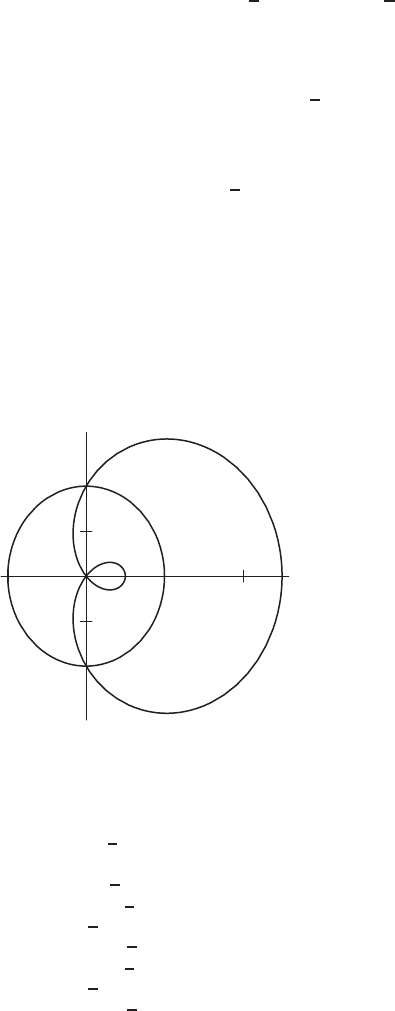
16.4 SOLUTIONS 1529
(b) In polar coordinates, the circle centered at the origin has equation r= 1. See Figure 16.99. The other circle, (x−
1)2+y2= 1, can be written as
x2−2x+ 1 + y2= 1
x2+y2= 2x,
so its equation in polar coordinates is
r2= 2rcos θ,
and, since r6= 0,
r= 2 cos θ.
At the top point of intersection of the two circles, x= 1/2,y=√3/2, so tan θ=√3, giving θ=π/3.
Figure 16.99 shows that if we integrate with respect to rfirst, we have to write the integral as the sum of two
integrals. Thus, we integrate with respect to θfirst. To do this, we rewrite
r= 2 cos θas θ= arccos r
2.
This gives the top half of the circle; the bottom half is given by
θ=−arccos r
2.
Thus the area is given by
Area =Z1
0Zarccos(r/2)
−arccos(r/2)
r dθdr.
36. The required region is shaded in Figure 16.100. The limits of integration will correspond to the two points where the two
curves intersect. These points are given by solving the equation 2+3 cos θ= 2.Simplifying this equation gives cos θ= 0
so the required solutions are θ=π/2and θ=−π/2as shown in Figure 16.100.
−2 2 4
−1
1
x
y
Figure 16.100
The required area is given by
ZR
1dA =Zπ
2
−π
2Z2+3 cos θ
2
r dr dθ
=1
2Zπ
2
−π
2
(2 + 3 cos θ)2−22dθ
=1
2Zπ
2
−π
2
12 cos θ+ 9 cos2θ dθ
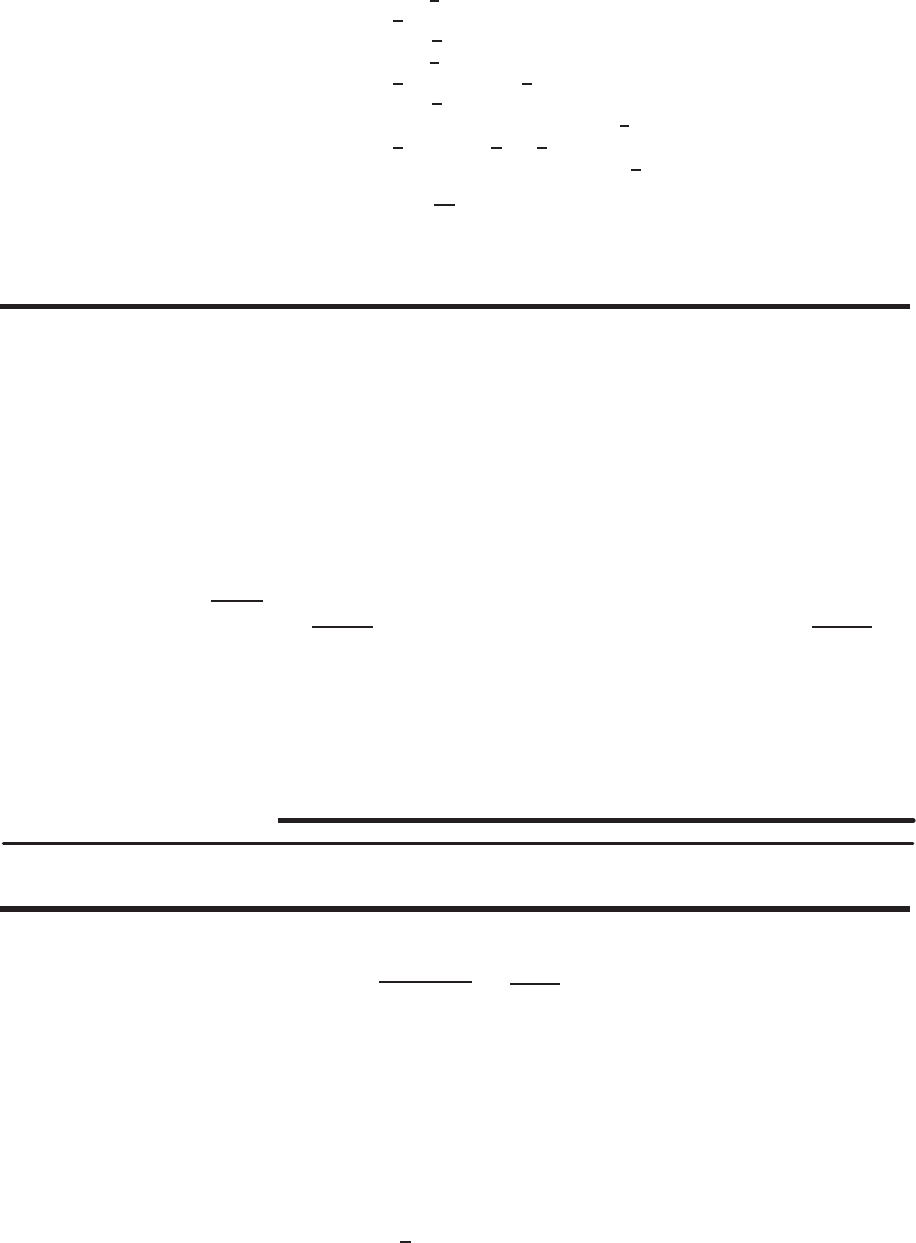
1530 Chapter Sixteen /SOLUTIONS
=3
2Zπ
2
−π
2
(4 cos θ+ 3 cos2θ)dθ
=3
2Zπ
2
−π
2
4 cos θ+3
2(1 + cos 2θ)dθ
=3
24 sin θ+3
2θ+3
4sin 2θ
π
2
−π
2
= 12 + 9π
4.
Strengthen Your Understanding
37. The part of the boundary of Rcorresponding to x= 1 in terms of polar coordinates is not r= 1. Rather, it is rcos θ= 1,
which gives r= 1/cos θ. The angle between y= 0 and y=xis π/4, so we have
ZR
xdA =Zπ/4
0Z1/cos θ
0
(rcos θ)r dr dθ.
38. When converting to polar coordinates, we need an extra factor of r, because dA =r dr dθ. Thus, we should have:
ZR
(x2+y2)dA=Z2π
0Z2
0
r2·r dr dθ =Z2π
0Z2
0
r3dr dθ
39. Any region that is a sector of a circle centered at the origin suggests polar coordinates. An example is the quarter disk
0≤x≤1,0≤y≤√1−x2.
40. Any integrand that is a function of px2+y2suggests polar coordinates. For example, let f(x, y) = 1/px2+y2.
41. (a), (c), (e)
42. The region lies in the first quadrant and is bounded by four lines. The equations r= 1/sin θand r= 4/sin θare the
horizontal lines y=rsin θ= 1 and y=rsin θ= 4. The equation θ=π/4gives the line y=x, and the equation
θ=π/2gives the y-axis.
Solutions for Section 16.5
Exercises
1. (a) is (IV); (b) is (II); (c) is (VII); (d) is (VI); (e) is (III); (f) is (V).
2. The plane has equation θ=π/4.
3. The top half of the sphere has equation z=p1−x2−y2=√1−r2.
4. The cone has equation z=r.
5. The cone has equation φ=π/4.
6. The plane has equation ρcos φ= 10 or ρ= 10/cos φ.
7. The plane has equation ρcos φ= 4 or ρ= 4/cos φ.
8.
ZW
fdV =Z3
−1Z2π
0Z1
0
(sin (r2)) rdr dθ dz
=Z3
−1Z2π
0
(−1
2cos r2)
1
0
dθ dz

16.5 SOLUTIONS 1531
=−1
2Z3
−1Z2π
0
(cos 1 −cos 0) dθ dz
=−πZ3
−1
(cos 1 −1) dz =−4π(cos 1 −1) = 4π(1 −cos 1)
9.
ZW
fdV =Z1
−1Z3π/4
π/4Z4
0
(r2+z2)rdr dθ dz
=Z1
−1Z3π/4
π/4
(64 + 8z2)dθ dz
=Z1
−1
π
2(64 + 8z2)dz
= 64π+8
3π=200
3π
10.
ZW
fdV =Z2π
0Zπ/4
0Z2
1
(sin φ)ρ2sin φ dρ dφ dθ
=Z2π
0Zπ/4
0Z2
1
ρ2sin2φ dρ dφ dθ
=7
3Z2π
0Zπ
4
0
sin2φ dφ dθ
=7
3Z2π
0Zπ/4
0
1−cos 2φ
2dφ dθ
=7
6Z2π
0
(φ−1
2sin 2φ)
π/4
0
dθ
=7
6Z2π
0
(π
4−1
2)dθ
=7
6·2π(π
4−1
2) = 7π(π−2)
12
11. We have:
ZW
fdV =Z5
0Z2π
0Zπ
π/2
1
ρ·ρ2sin φ dφ dθ dρ
=Z5
0Z2π
0Zπ
π/2
ρsin φ dφ dθ dρ
=Z5
0Z2π
0
ρdθ dρ
= 2πZ5
0
ρ dρ = 25π
Note that the integral is improper, but it can be shown that the result is correct.
12. Using Cartesian coordinates, we get:
Z3
0Z1
0Z5
0
fdz dy dx
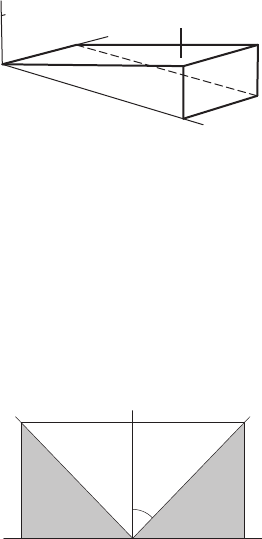
1532 Chapter Sixteen /SOLUTIONS
13. Using cylindrical coordinates, we get:
Z1
0Z2π
0Z4
0
f·rdr dθ dz
14. Using cylindrical coordinates, we get:
Z4
0Zπ/2
0Z2
0
f·rdr dθ dz
15. Using spherical coordinates, we get:
Zπ
0Zπ
0Z3
2
f·ρ2sin φ dρ dφ dθ
16. Using spherical coordinates, we get:
Z2π
0Zπ/6
0Z3
0
f·ρ2sin φ dρ dφ dθ
17. We use Cartesian coordinates, oriented as shown in Figure 16.101. The slanted top has equation z=mx, where mis the
slope in the x-direction, so m= 1/5. Then if fis an arbitrary function, the triple integral is
Z5
0Z2
0Zx/5
0
fdz dy dx.
Other answers are possible.
x
y
z
1
2
5
(5,2,0)
(5,2,1)
❄
(5,0,1)
Figure 16.101
18. We choose cylindrical coordinates oriented as in Figure 16.102. The cone has equation z=r. Since we have a half cone
scooped out of a half cylinder, θvaries between 0and π. Thus, if fis an arbitrary function, the integral is
Zπ
0Z2
0Zr
0
fr dzdrdθ.
Other answers are possible.
2
2
z=r
π/4
x
z
Figure 16.102
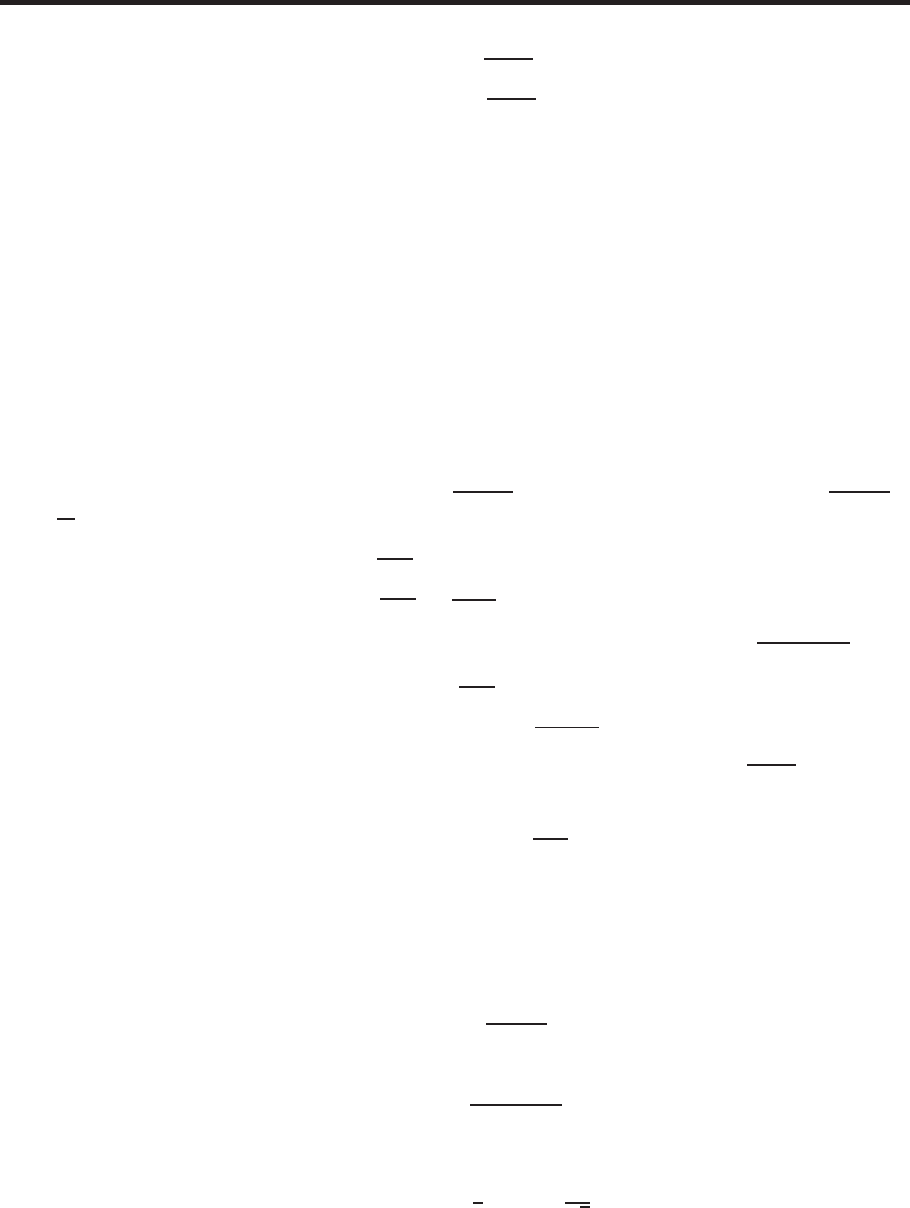
16.5 SOLUTIONS 1533
Problems
19. In cylindrical coordinates, the sphere has equation r2+z2=K2.Thus
V=Z2π
0ZK
0Z√K2−r2
−√K2−r2
r dz dr dθ.
20. In spherical coordinates, the sphere has equation ρ=K. Thus
V=Zπ
0ZK
0Z2π
0
ρ2sin φ dθ dρ dφ.
21. We use cylindrical coordinates. The cone has radius r= 2 when z= 4, so its equation is z= 2r. Thus, the integral is
Z2π
0Z2
0Z4
2r
f(r, θ, z)r dz dr dθ.
22. We use spherical coordinates. The cone has radius 2 when z= 4, so ρsin φ= 2 when ρcos φ= 4. Thus tan φ= 1/2,
so φ= arctan(1/2). The top of the cone, z= 4, is given by ρcos φ= 4. Thus, the integral is
Z2π
0Zarctan(1/2)
0Z4/cos φ
0
g(ρ, φ, θ)ρ2sin θ dρ dφ dθ.
23. In rectangular coordinates, a cone has equation z=kpx2+y2for some constant k. Since z= 4 when px2+y2=
√22= 2, we have k= 2. Thus, the integral is
Z2
−2Z√4−x2
−√4−x2Z4
2√x2+y2
h(x, y, z)dz dy dx.
24. (a) In Cartesian coordinates, the bottom half of the sphere x2+y2+z2= 1 is given by z=−p1−x2−y2. Thus
ZW
dV=Z1
0Z√1−x2
0Z0
−√1−x2−y2
dz dy dx.
(b) In cylindrical coordinates, the sphere is r2+z2= 1 and the bottom half is given by z=−√1−r2. Thus
ZW
dV =Zπ/2
0Z1
0Z0
−√1−r2
r dz dr dθ.
(c) In spherical coordinates, the sphere is ρ= 1. Thus,
ZW
dV=Zπ/2
0Zπ
π/2Z1
0
ρ2sin φ dρ dφ dθ.
25. (a) Since the cone has a right angle at its vertex, it has equation
z=px2+y2.
The sphere has equation x2+y2+z2= 1, so the top half is given by
z=p1−x2−y2.
The cone and the sphere intersect in the circle
x2+y2=1
2, z =1
√2.
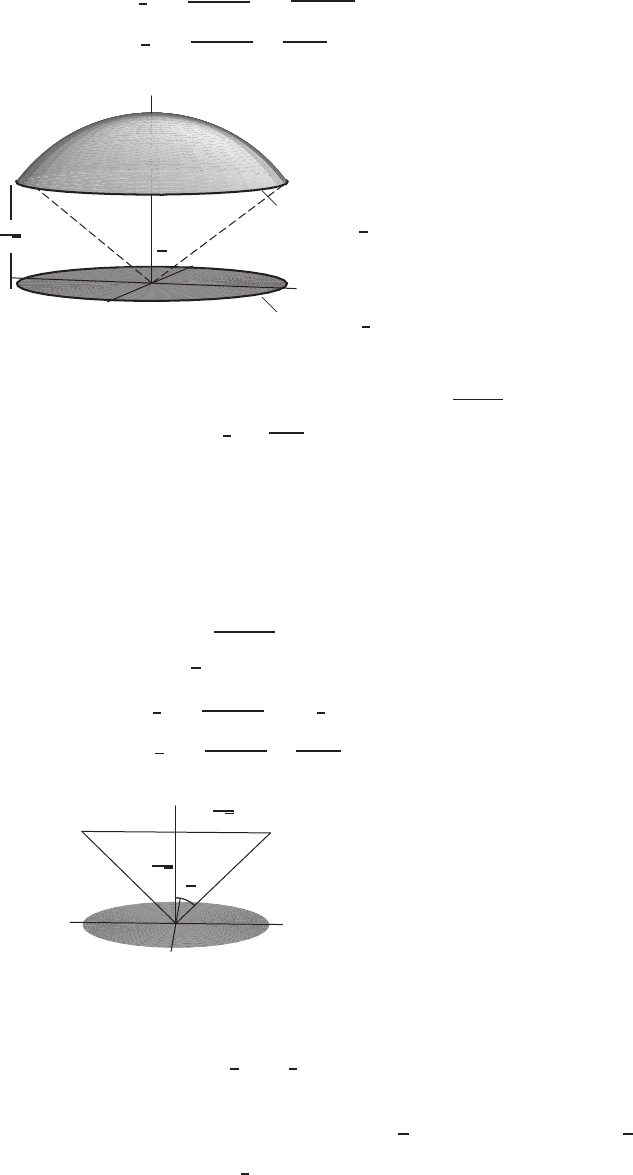
1534 Chapter Sixteen /SOLUTIONS
See Figure 16.103. Thus
ZW
dV=Z1/√2
−1/√2Z√(1/2)−x2
−√(1/2)−x2Z√1−x2−y2
√x2+y2
dz dy dx.
x
y
z
1
■x2+y2=1
2
■
Circle is
x2+y2=1
2
✻
❄
1
√2π
4
Figure 16.103
(b) In cylindrical coordinates, the cone has equation z=rand the sphere has equation z=√1−r2. Thus
ZW
dV=Z2π
0Z1/√2
0Z√1−r2
r
r dz dr dθ.
(c) In spherical coordinates, the cone has equation φ=π/4and the sphere is ρ= 1. Thus
ZW
dV=Z2π
0Zπ/4
0Z1
0
ρ2sin φ dρ dφ dθ.
26. (a) Since the cone has a right angle at its vertex, it has equation
z=px2+y2.
Figure 16.104 shows the plane with equation z= 1/√2. The plane and the cone intersect in the circle x2+y2= 1/2.
Thus,
ZW
dV=Z1/√2
−1/√2Z√(1/2)−x2
−√(1/2)−x2Z1/√2
√x2+y2
dz dy dx.
x
y
z
1
√2
1
√2π
41
Figure 16.104
(b) In cylindrical coordinates the cone has equation z=r, so
ZW
dV=Z2π
0Z1/√2
0Z1/√2
r
r dz dr dθ.
(c) In spherical coordinates, the cone has equation φ=π/4and the plane z= 1/√2has equation ρcos φ= 1/√2.
Thus ZW
dV =Z2π
0Zπ/4
0Z1/(√2 cos φ)
0
ρ2sin φ dρ dφ dθ.
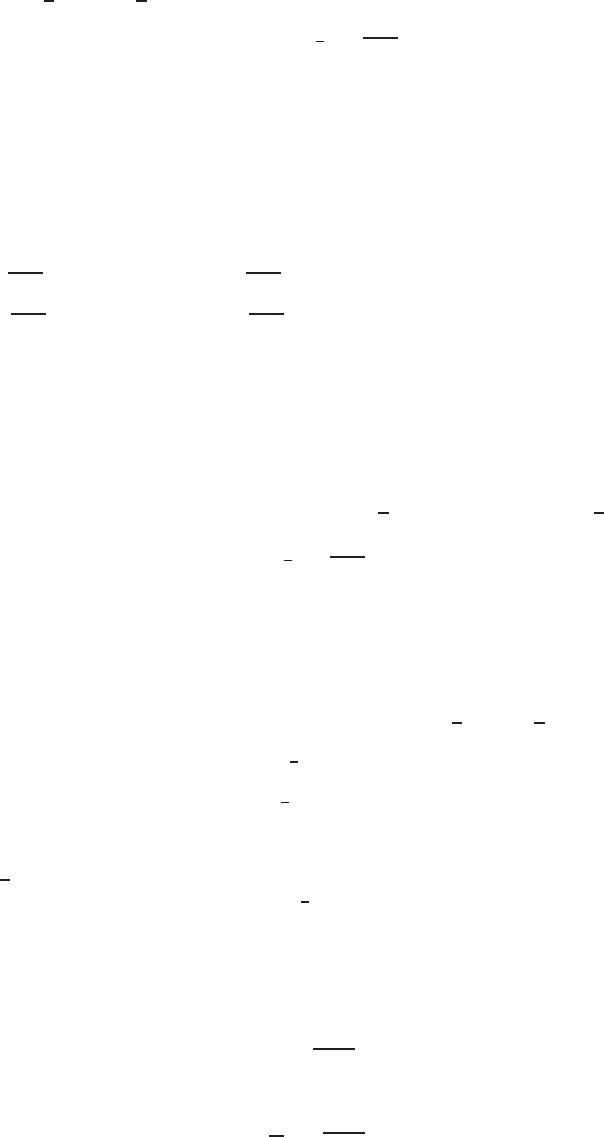
16.5 SOLUTIONS 1535
27. (a) In cylindrical coordinates, the cone is z=rand the sphere is r2+z2= 4. The surfaces intersect where z2+z2=
2z2= 4. So z=√2and r=√2.
Volume =Z2π
0Z√2
0Z√4−r2
r
r dzdrdθ.
(b) In spherical coordinates, the cone is φ=π/4and the sphere is ρ= 2.
Volume =Z2π
0Zπ/4
0Z2
0
ρ2sin φ dρdφdθ.
28. (a) Z2π
0Zπ
0Z2
1
ρ2sin φ dρdφdθ.
(b) Z2π
0Z2
0Z√4−r2
−√4−r2
r dzdrdθ −Z2π
0Z1
0Z√1−r2
−√1−r2
r dzdrdθ.
29. We want the volume of the region above the cone φ=π/3and below the sphere ρ= 3:
V=Z2π
0Zπ/3
0Z3
0
ρ2sin φ dρ dφ dθ.
The order of integration can be altered and other coordinates can be used.
30. We want the volume of the region between the sphere ρ= 3 and the cone z=r. The sphere can also be written
x2+y2+z2= 32or r2+z2= 9. The cone can also be written as φ=π/4.
The sphere cuts the cone z=rin the circle 2r2= 9, or r= 3/√2, lying in the plane z= 3/√2.
In cylindrical coordinates,
V=Z2π
0Z3/√2
0Z√9−r2
r
rdz dr dθ.
In spherical coordinates
V=Z2π
0Zπ/4
0Z3
0
ρ2sin φ dρ dφ dθ.
The order of integration can be altered and other coordinates can be used.
31. In cylindrical coordinates, the region is the half cylinder given by 5≤z≤10,√2≤r≤√3,0≤θ≤π. Thus
V=Zπ
0Z√3
√2Z10
5
r dz dr dθ.
The order of integration can be altered and other coordinates can be used.
32. The cone can be written z=r, and the first quadrant of the xy-plane is given by 0≤θ≤π/2. The region x2+y2≤7
is given by r≤√7. Thus
V=Zπ/2
0Z√7
0Zr
0
r dz dr dθ.
The order of integration can be altered and other coordinates can be used.
33. We use cylindrical coordinates since the sphere x2+y2+z2= 10, or r2+z2= 10, and the plane z= 1 can both be
simply expressed. The plane cuts the sphere in the circle r2+ 12= 10, or r= 3. Thus
V=Z2π
0Z3
0Z√10−r2
1
r dz dr dθ,
or
V=Z2π
0Z√10
1Z√10−z2
0
r dr dz dθ.
Order of integration can be altered and other coordinates can be used.
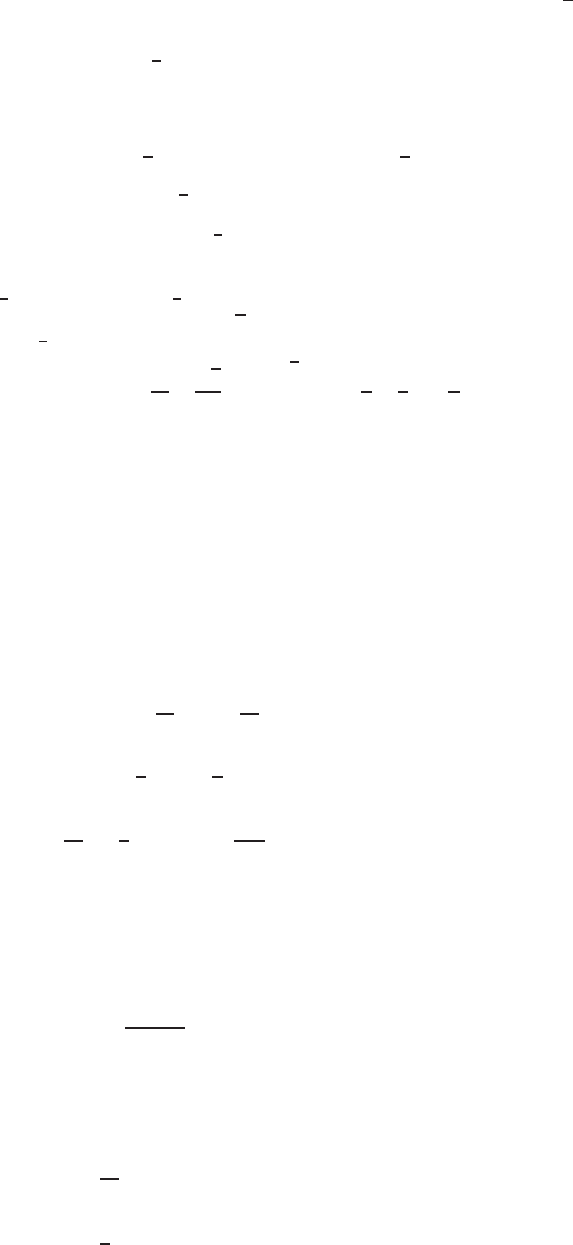
1536 Chapter Sixteen /SOLUTIONS
34. In spherical coordinates, the cone z=ris given by φ=π/4and the sphere x2+y2+z2= 8 is given by ρ=√8.
Since φis measured from the positive z-axis, the region we are interested in has π/4≤φ≤π/2. Thus
V=Z2π
0Zπ/2
π/4Z√8
0
ρ2sin φ dρ dφ dθ.
The order of integration can be altered and other coordinates can be used.
35. (a) In cylindrical coordinates, the cone has equation z=√3r. When z= 1, we have r= 1/√3, so
Volume =Z2π
0Z1/√3
0Z1
√3r
r dz dr dθ.
(b) Evaluating gives
Volume = 2πZ1√3
0
z
1
√3r
r dr = 2πZ1√3
0
(1 −√3r)r dr
= 2πr2
2−√3
3r3
1/√3
0
= 2π1
6−1
9=π
9.
36. For x2+y2≤1, the cone is below the plane z= 10 + x. In cylindrical coordinates, the plane is z= 10 + rcos θ, and
the cone is z=r. Thus
Volume =Z2π
0Z1
0Z10+rcos θ
r
r dz dr dθ
=Z2π
0Z1
0
rz
10+rcos θ
r
dr dθ
=Z2π
0Z1
0
(10r+r2cos θ−r2)dr dθ
=Z2π
05r2+r3
3cos θ−r3
3
1
0
dθ
=Z2π
05 + 1
3cos θ−1
3dθ
=14
3θ+1
3sin θ
2π
0
=28π
3.
37. The cone is centered along the positive x-axis and intersects the sphere in the circle
(y2+z2) + y2+z2= 4
y2+z2= 2.
We use spherical coordinates with φmeasured from the x-axis and θmeasured in the yz-plane. (Alternatively, the volume
we want is equal to the volume between the cone z=px2+y2and the sphere x2+y2+z2= 4.) The cone is given
by φ=π/4. The sphere has equation ρ= 2. Thus
Volume =Z2π
0Zπ/4
0Z2
0
ρ2sin φ dρ dφ dθ
=Z2π
0Zπ/4
0
ρ3
3sin φ
2
0
dφ dθ
=Z2π
0Zπ/4
0
8
3sin φ dφ dθ
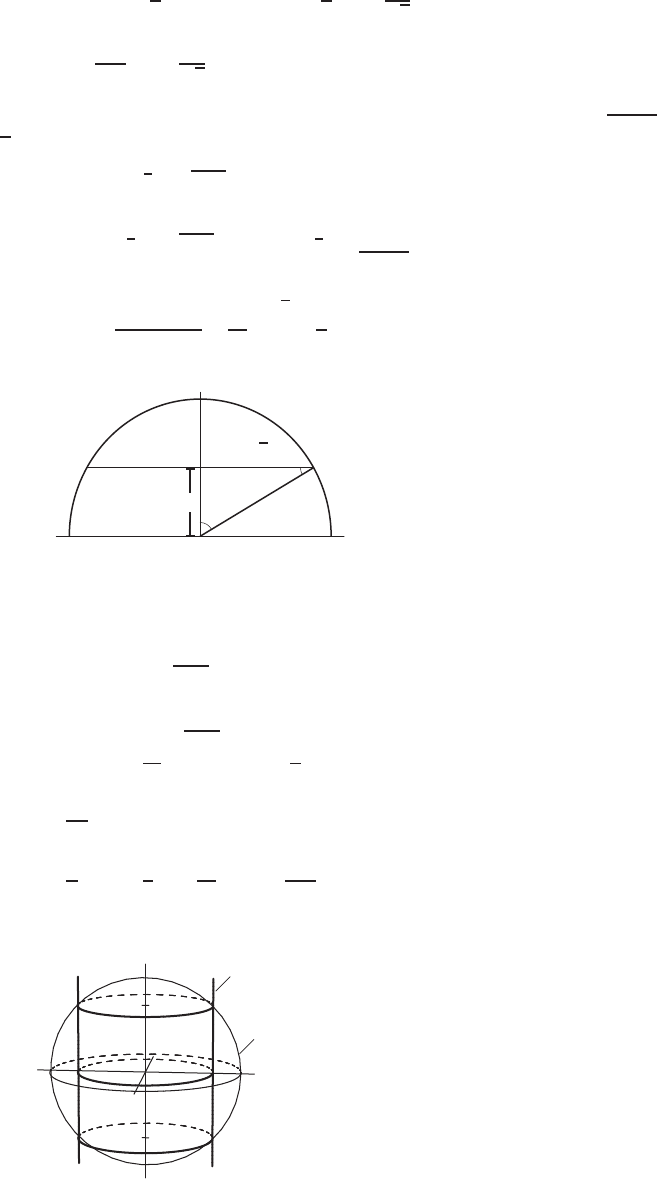
16.5 SOLUTIONS 1537
=Z2π
0−8
3cos φ
π/4
0
dθ =Z2π
0
8
31−1
√2dθ
=16π
31−1
√2.
38. Using cylindrical coordinates, the equation of the sphere is r2+z2= 4. The top of the sphere has equation z=√4−r2.
When z= 1 we have r=√3. Figure 16.105 shows the limits of integration on the integral.
Volume =Z2π
0Z√3
0Z√4−r2
1
r dz dr dθ
= 2πZ√3
0
rz
√4−r2
1
dr = 2πZ√3
0
(rp4−r2−r)dr
= 2π(4 −r2)3/2
−3−r2
2
√3
0
=5
3π.
1
2
π/3
π/6
√3
✻
❄
1
r
z
Figure 16.105
39. Use cylindrical coordinates: when r2=x2+y2= 1, then x2+y2+z2= 1 + z2= 2 so z=±1. The region Wis
shown in Figure 16.106.
ZW
(x2+y2)dV=Z1
−1Z2π
0Z√2−z2
1
r2·rdrdθdz
=Z1
−1Z2π
0
r4
4
√2−z2
1
dθdz =1
4Z1
−1Z2π
0(2 −z2)2−1dθdz
=2π
4Z1
−13−4z2+z4dz
=π
23z−4
3z3+z5
5
1
−1
=28π
15 .
x
y
z
✠
Cylinder
x2+y2= 1
✠
Sphere
x2+y2+z2= 2
−1
1
Figure 16.106
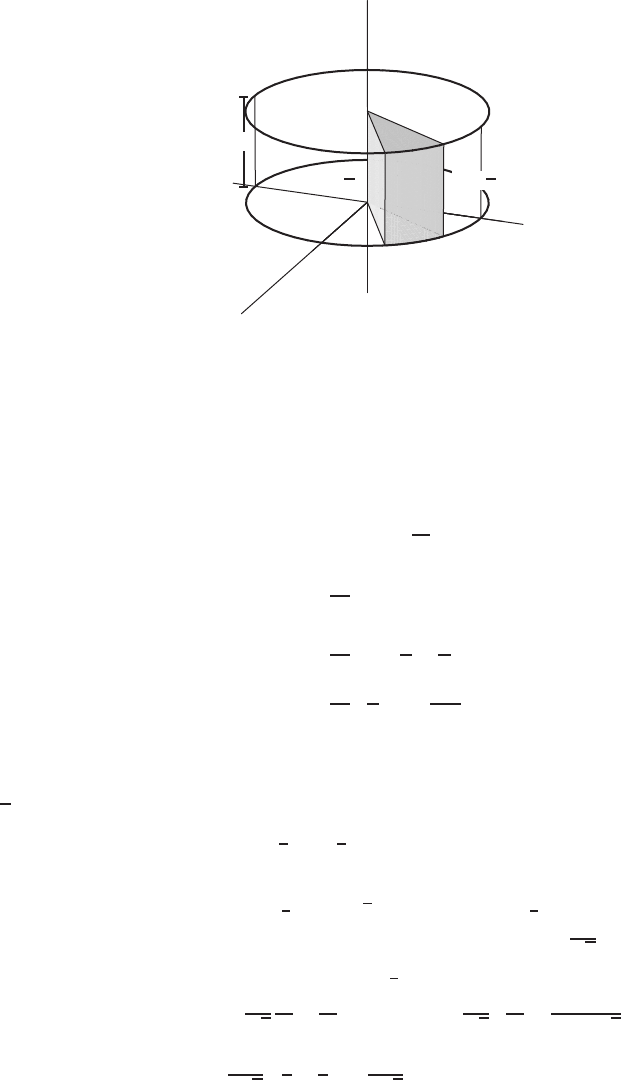
1538 Chapter Sixteen /SOLUTIONS
40. The region whose volume we want is shown in Figure 16.107:
x
y
z
θ=π
6θ=π
3
5
✻
❄
2
Figure 16.107
Using cylindrical coordinates, the volume is given by the integral:
V=Z2
0Zπ/3
π/6Z5
0
r dr dθ dz
=Z2
0Zπ/3
π/6
r2
2
5
0
dθ dz
=25
2Z2
0Zπ/3
π/6
dθ dz
=25
2Z2
0π
3−π
6dz
=25
2·π
6·2 = 25π
6.
41. Orient the cone as shown in Figure 16.108 and use cylindrical coordinates with the origin at the vertex of the cone. Since
the angle at the vertex of the cone is a right angle, the angles AOB and COB are both π/4. Thus, OB = 5 cos π/4 =
5/√2. The curved surface of the cone has equation z=r, so
Volume =Z2π
0Z5/√2
0Z5/√2
r
r dz dr dθ
=Z2π
0Z5/√2
0
rz
z=5/√2
z=r
dr dθ =Z2π
0Z5/√2
0
r5
√2−rdr dθ
=θ
2π
05
√2
r2
2−r3
3
5/√2
0
= 2π5
√2·52
22−53
2·3·√2
= 2π·53
2√21
2−1
3=53π
6√2= 46.28 cm3.

16.5 SOLUTIONS 1539
5/√2
ABC
O
✢
π/4
❫
π/45
r
z
Figure 16.108
42. (a) The angle φtakes on values in the range 0≤φ≤π. Thus, sin φis nonnegative everywhere in W1, and so its integral
is positive.
(b) The function φis symmetric across the xy plane, such that for any point (x, y, z)in W1, with z6= 0, the point
(x, y, −z)has a cos φvalue with the same magnitude but opposite sign of the cos φvalue for (x, y, z). Furthermore,
if z= 0, then (x, y, z)has a cos φvalue of 0. Thus, with cos φpositive on the top half of the sphere and negative on
the bottom half, the integral will cancel out and be equal to zero.
43. (a) The integral is negative. In W2, we have 0< z < 1. Thus, z2−zis negative throughout W2and thus its integral is
negative.
(b) On the top half of the sphere, zis nonnegative, but xcan be both positive and negative. Thus, since W2is symmetric
with respect to the yz plane, the contribution of a point (x, y, z)will be canceled out by its reflection (−x, y, z).
Thus, the integral is zero.
44. We must first decide on coordinates. We pick cylindrical coordinates with the z-axis along the axis of the cylinders. The
insulation stretches from z= 0 to z=l. See Figure 16.109. The volume is given by the integral
Volume =Z2π
0Zl
0Za+h
a
rdrdzdθ.
Evaluating the integral gives
Volume =Z2π
0Zl
0
r2
2
a+h
a
dzdθ = 2πz
l
0(a+h)2
2−a2
2=πl((a+h)2−a2).
To check our answer, notice that the volume is the difference between the volume of two cylinders of radius aand a+h.
These cylinders have volumes πl(a+h)2and πla2, respectively.
x
y
z
aa+h
✲✛ h✲✛ a
✻
❄
l
Figure 16.109
45. The plane (x/p) + (y/q) + (z/r) = 1 cuts the axes at the points (p, 0,0);(0, q, 0);(0,0, r). Since p, q, r are positive,
the region between this plane and the coordinate planes is a pyramid in the first octant. Solving for zgives
z=r1−x
p−y
q=r−rx
p−ry
q.
The volume, V, is given by the double integral
V=ZRr−rx
p−ry
qdA,
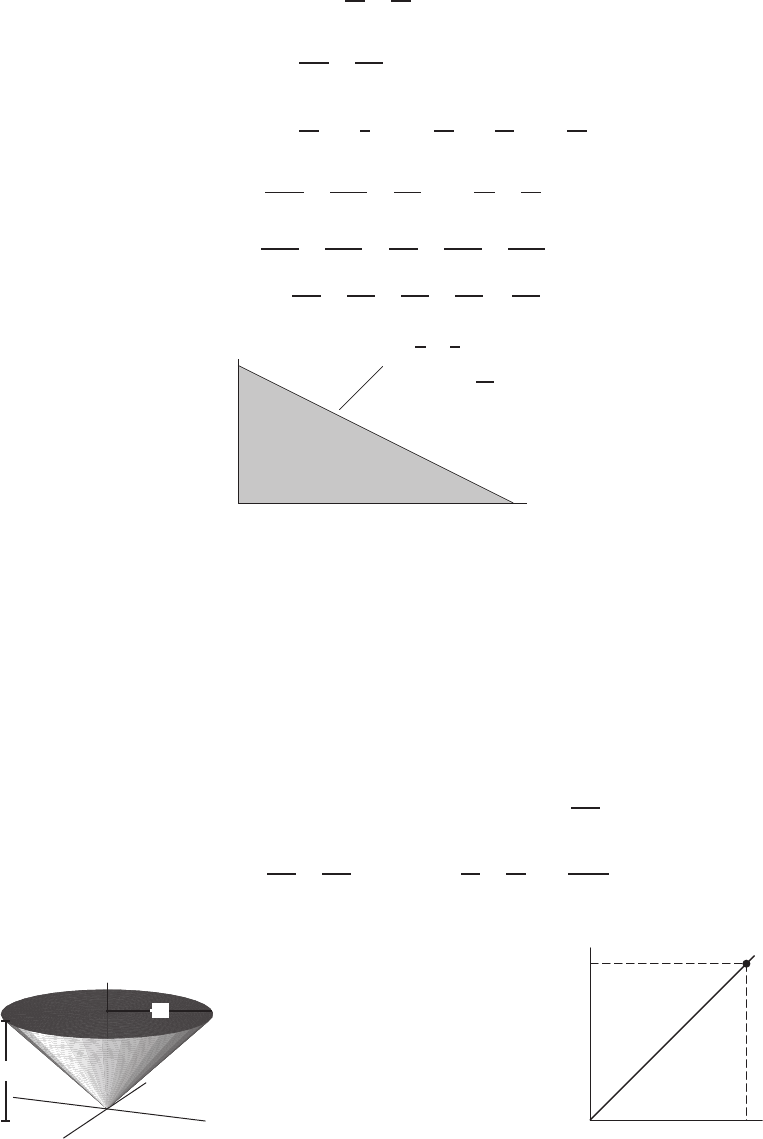
1540 Chapter Sixteen /SOLUTIONS
where Ris the region shown in Figure 16.110. Thus
V=Zp
0Zq−qx/p
0r−rx
p−ry
qdydx
=Zp
0 ry −rxy
p−ry2
2q
y=q−qx/p
y=0 !dx
=Zp
0 rq−qx
p−r
pxq−qx
p−r
2qq−qx
p2!dx
=Zp
0
rq−2rqx
p+rqx2
p2−rq2
2q1−2x
p+x2
p2dx
=rqx −rqx2
p+rqx3
p23−rqx
2+rqx2
p2−rqx3
2p23
p
0
=pqr −pqr +pqr
3−pqr
2+pqr
2−pqr
6=pqr
6.
p
q
R
x
p+y
q= 1
y=q−qx
p
✠
x
y
Figure 16.110
46. We must first decide on coordinates. We imagine the vertex of the cone downward, at the origin, with the flat base in the
plane z=h, as in Figure 16.111. Then, using cylindrical coordinates as in Figure 16.112, we see that the curved surface
of the cone has equation z=hr/a. Thus the volume is given by
Volume =Z2π
0Za
0Zh
hr/a
r dzdrdθ.
Evaluating gives
Volume =Z2π
0Za
0
rz
z=h
z=hr/a
drdθ =Z2π
0Za
0hr −hr2
adrdθ
=2πhr2
2−hr3
3a
a
0
= 2πh a2
2−a2
3=πha2
3.
x
y
z
✲✛ a
✻
❄
h
Figure 16.111
a
h
z=hr/a
r
z
Figure 16.112
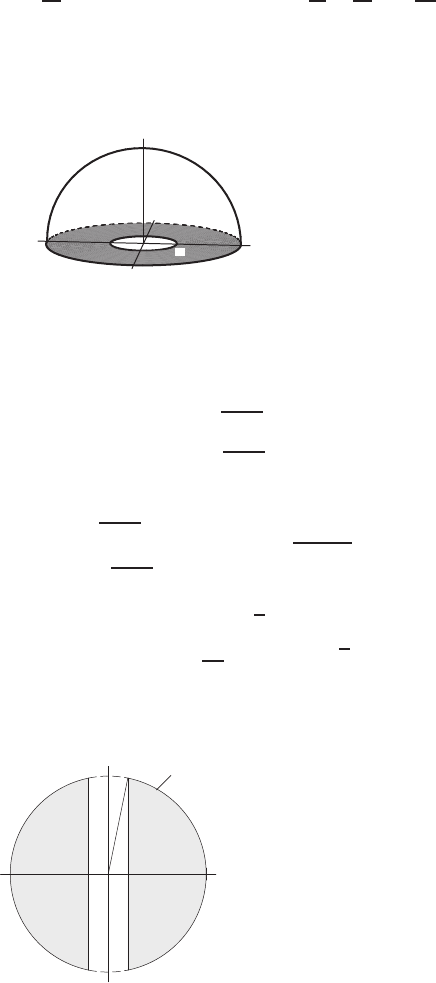
16.5 SOLUTIONS 1541
47. We must first decide on coordinates. We pick spherical coordinates with the common center of the two spheres as the
origin. We imagine the half-melon with the flat side horizontal and the positive z-axis going through the curved surface.
See Figure 16.113. The volume is given by the integral
Volume =Z2π
0Zπ/2
0Zb
a
ρ2sin φ dρdφdθ.
Evaluating gives
Volume =Z2π
0Zπ/2
0
sin φρ3
3
p=b
p=a
dφdθ = 2π(−cos φ)
π/2
0b3
3−a3
3=2π
3(b3−a3).
To check our answer, notice that the volume is the difference between the volumes of two half spheres of radius aand b.
These half spheres have volumes 2πb3/3and 2πa3/3, respectively.
x
y
z
ab
Figure 16.113
48. (a) We use the axes shown in Figure 16.114. Then the sphere is given by r2+z2= 25, so
Volume =Z2π
0Z5
1Z√25−r2
−√25−r2
r dzdrdθ.
(b) Evaluating gives
Volume = 2πZ5
1
rz
z=√25−r2
z=−√25−r2
dr = 2πZ5
1
2rp25 −r2dr
= 2π−2
3(25 −r2)3/2
5
1
=4π
3(24)3/2= 64√6π= 492.5mm3.
1 5
5
✠
r2+z2= 25
x2+y2+z2= 25
x
y
Figure 16.114
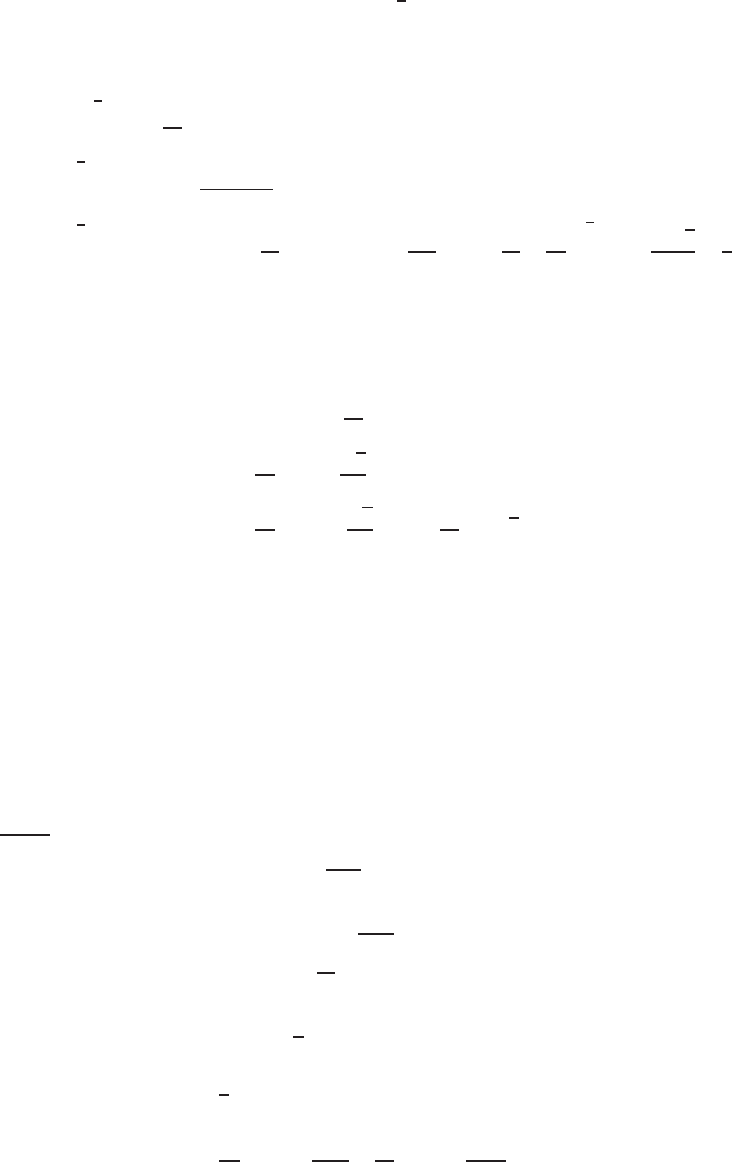
1542 Chapter Sixteen /SOLUTIONS
49. (a) To find the mass, we integrate the density over the region, W. Converting to cylindrical coordinates, the surface of
the pile is z= 2 −r2, so we have
Mass =ZW
(2−z)dV =Z2π
0Z√2
0Z2−r2
0
(2−z)r dz dr dθ.
(b) Evaluating gives
Mass =Z2π
0Z√2
02z−z2
2
2−r2
0
rdr dθ
= 2πZ√2
02(2 −r2)−(2 −r2)2
2r dr
= 2πZ√2
0
4−2r2−2r+ 2r3−r5
2dr = 2π 4r−2r3
3−r2+r4
2−r6
12
√2
0!=16√2
3−4
3π.
50. The density function can be rewritten as δ(ρ, φ, θ) = ρ. So the mass is
ZW
δ(P)dV=Z2π
0Zπ/4
0Z3
0
ρ·ρ2sin φ dρ dφ dθ
=Z2π
0Zπ/4
0
81
4sin φ dφ dθ
=81
4Z2π
0
(−√2
2+ 1) dθ
=81
4·2π·(−√2
2+ 1) = 81
4π(−√2 + 2)
51. We use spherical coordinates because we are integrating over a sphere and the density has spherical symmetry. D= 2ρ.
M=Z2π
0Zπ
0Z3
0
(2ρ)ρ2sin φ dρ dφ dθ.
52. Using cylindrical coordinates, the density is given by δ=kr2gm/cm3, where kis a constant. Since δ= 2 when r= 2,
we have
2 = k22so k= 0.5.
The equation of the sphere is x2+y2+z2= 32, and in cylindrical coordinates,
r2+z2= 9.
Thus r=√9−z2on the sphere, so
Mass =Z2π
0Z3
−3Z√9−z2
0
(0.5r2)r dr dz dθ
=Z2π
0Z3
−3
0.5r4
4
√9−z2
0
dz dθ
=Z2π
0Z3
−3
1
8(9 −z2)2dz dθ
=1
8Z2π
0Z3
−3
(81 −18z2+z4)dz dθ
=2π
881z−18z3
3+z5
5
3
−3
=324π
5gm.
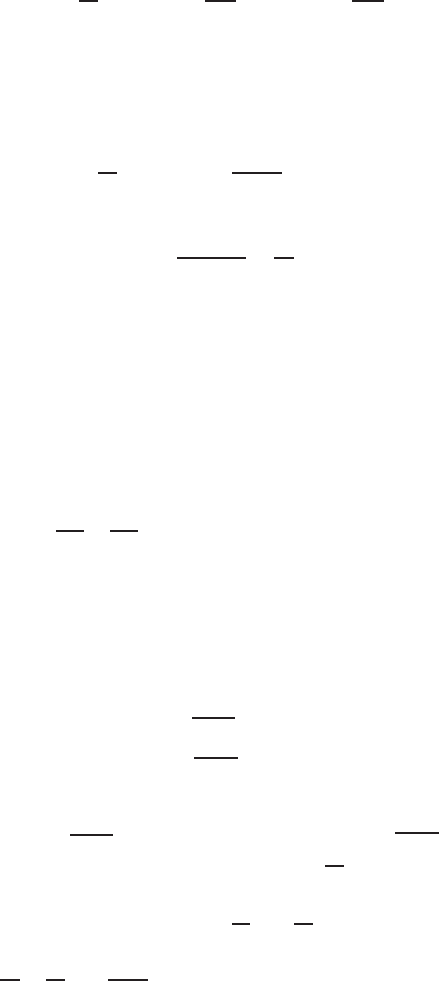
16.5 SOLUTIONS 1543
53. We use spherical coordinates. The density, δ, of the sphere at a distance ρfrom the center is
δ=kρ2for ka positive constant.
Thus, for a sphere of radius 1,
Mass =Z2π
0Zπ
0Z1
0
kρ2·ρ2sin θ dρ dφ dθ
= 2πZπ
0
kρ5
5sin φ
1
0
dφ=2πk
5(−cos φ)
π
0
=4πk
5.
For a sphere of radius 2, a similar calculation gives
Mass =Z2π
0Zπ
0Z2
0
kρ2·ρ2sin θ dρ dφ dθ
= 2πk 25
5(−cos φ)
π
0
=128πk
5.
Therefore
Ratio of masses =4πk/5
128πk/5=1
32 .
54. (a) We use spherical coordinates. Since δ= 9 where ρ= 6 and δ= 11 where ρ= 7, the density increases at a rate
of 2 gm/cm3for each cm increase in radius. Thus, since density is a linear function of radius, the slope of the linear
function is 2. Its equation is
δ−11 = 2(ρ−7) so δ= 2ρ−3.
(b) Thus,
Mass =Z2π
0Zπ
0Z7
6
(2ρ−3)ρ2sin φ dρ dφ dθ.
(c) Evaluating the integral, we have
Mass = 2π−cos φ
π
0 2ρ4
4−3ρ3
3
7
6!= 2π·2(425.5) = 1702πgm = 5346.991 gm.
55. (a) First we must choose a coordinate system, since none is given. We pick the xy-plane to be the fixed plane and the
z-axis to be the line perpendicular to the plane. Then the distance from a point to the plane is |z|, so the density at a
point is given by
Density =ρ=k|z|.
Using cylindrical coordinates for the integral, we find
Mass =Z2π
0Za
0Z√a2−r2
−√a2−r2
k|z|r dzdrdθ.
(b) By symmetry, we can evaluate this integral over the top half of the sphere, where |z|=z. Then
Mass = 2 Z2π
0Za
0Z√a2−r2
0
kzr dzdrdθ = 2kZ2π
0Za
0
z2
2r
z=√a2−r2
z=0
drdθ
=kZ2π
0Za
0
r(a2−r2)drdθ =k2πr2
2a2−r4
4
a
0
= 2πk a4
2−a4
4=πka4
2.

1544 Chapter Sixteen /SOLUTIONS
56. The distance from a point (x, y, z)to the origin is given by px2+y2+z2. Thus we want to evaluate
RRpx2+y2+z2dV
Vol(R)
where Ris the region bounded by the hemisphere z=p8−x2−y2and the cone z=px2+y2. See Figure 16.115.
We will use spherical coordinates.
x
y
z
✛
✛
2
x2+y2= 4
✛
Figure 16.115
In spherical coordinates, the quantity ρgoes from 0 to √8, and θgoes from 0 to 2π, and φgoes from 0 to π/4
(because the angle of the cone is π/4). Thus we have
ZRpx2+y2+z2dV =Z2π
0Zπ/4
0Z√8
0
ρ(ρ2sin φ)dρdφdθ
=Z2π
0Zπ/4
0
sin φ·ρ4
4
√8
0
dφdθ
=Z2π
0Zπ/4
0
16 sin φ dφdθ
=Z2π
0
16(−cos φ)
π/4
0
dθ
=Z2π
0
16 1−√2
2dθ
= 32 1−√2
2π
From Problem 27 of Section 16.4 we know that Vol(R) = 32π(√2−1)/3, therefore
Average distance =RRpx2+y2+z2dV
Vol(R)
=
32 1−√2
2π
[32(√2−1)π/3] =3
√2.

16.5 SOLUTIONS 1545
57. The total volume of the cone is 1
3πr2h=1
3π·12·1 = 1
3π, so the total mass is 1
3π(since the density is always 1). The
center of mass z-coordinate is given by
¯z=3
πZC
z dV
Using cylindrical coordinates to evaluate this integral gives
¯z=3
πZ2π
0Z1
0Zz
0
zr dr dz dθ
=3
πZ2π
0Z1
0
z3
2dz dθ
=3
πZ2π
0
1
8dθ =3
4
58. (a) The mass mof the cone is given by RCδdV . In cylindrical coordinates this is
m=Z2π
0Z1
0Zz
0
z2r dr dz dθ
=Z2π
0Z1
0
z4
2dz dθ
=Z2π
0
1
10 dθ =π
5
(b) The center of mass z-coordinate is given by
¯z=5
πZC
z·z2dV
Using cylindrical coordinates to evaluate this integral gives
¯z=5
πZ2π
0Z1
0Zz
0
z3r dr dz dθ
=5
πZ2π
0Z1
0
z5
2dz dθ
=5
πZ2π
0
1
12 dθ =5
6
Comparing this answer with the center of mass in Problem 57, where the density was constant, it makes sense
that the center of mass would be higher in this problem, since more mass is concentrated near the top of the cone.
59. We first need to find the mass of the solid, using cylindrical coordinates:
m=Z2π
0Z1
0Z√z/a
0
r dr dz dθ
=Z2π
0Z1
0
z
2adz dθ
=Z2π
0
1
4adθ =π
2a
It makes sense that the mass would vary inversely with a, since increasing amakes the paraboloid skinnier. Now for
the z-coordinate of the center of mass, again using cylindrical coordinates:
¯z=2a
πZ2π
0Z1
0Z√z/a
0
zr dr dz dθ
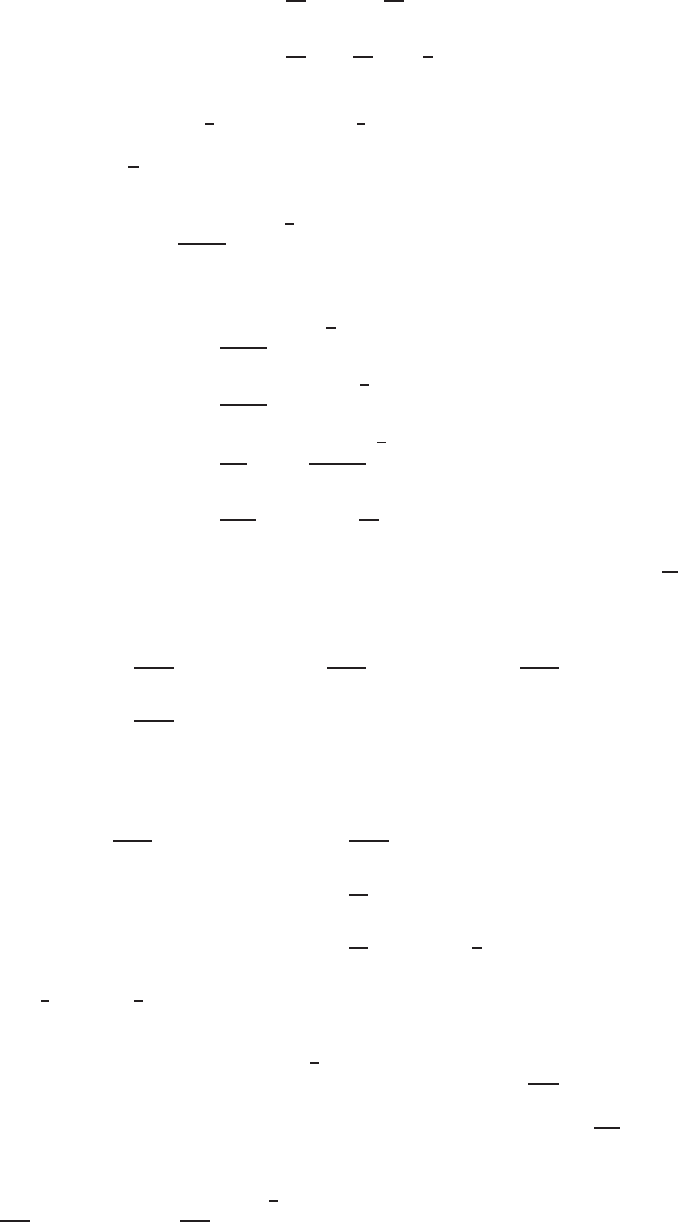
1546 Chapter Sixteen /SOLUTIONS
=2a
πZ2π
0Z1
0
z2
2adz dθ
=2a
πZ2π
0
1
6adθ =2
3
60. The volume of the hemisphere is 2
3πa3so its mass is 2
3πa3b. To find the location of the center of mass, we place the
base of the hemisphere on the xy-plane with the origin at its center, so we can describe it in spherical coordinates by
0≤ρ≤a,0≤φ≤π
2and 0≤θ≤2π. Then the x-coordinate of the center of mass is, integrating using spherical
coordinates:
¯x=3
2πa3bZa
0Zπ
2
0Z2π
0
ρsin(φ) cos(θ)·ρ2sin(φ)dθ dφ dρ = 0
since the first integral R2π
0cos(θ)dθ is zero. A similar computation shows that ¯y= 0. Now for the z-coordinate:
¯z=3
2πa3bZa
0Zπ
2
0Z2π
0
ρcos(φ)·ρ2sin(φ)dθ dφ dρ
=3
2πa3b·2πZa
0Zπ
2
0
ρ3cos(φ) sin(φ)dφ dρ
=3
a3bZa
0
ρ3sin2(φ)
2
π
2
0
dρ
=3
2a3bZa
0
ρ3dρ =3a
8b
So the xand y-coordinates are located at the center of the base, while the z-coordinate is located 3a
8babove the center of
the base.
61. The sum of the three moments of inertia Ifor the ball Bwill be
3I=3
4πa3ZB
(y2+z2)dV +3
4πa3ZB
(x2+z2)dV +3
4πa3ZB
(x2+y2)dV
=3
4πa3ZB
(2x2+ 2y2+ 2z2)dV,
which, in spherical coordinates is
3
2πa3ZB
(x2+y2+z2)dV=3
2πa3Za
0Zπ
0Z2π
0
ρ2·ρ2sin(φ)dθ dφ dρ
=3
a3Za
0Zπ
0
ρ4sin(φ)dφ dρ
=6
a3Za
0
ρ4dρ =6
5a2.
Thus 3I=6
5a2, so I=2
5a2.
62. First we need to find the volume of the cone. In spherical coordinates we find:
V=Za
0Zπ
3
0Z2π
0
ρ2sin(φ)dθ dφ dρ =πa3
3
Now, to find the moment of inertia about the z-axis we need to compute the integral 3
πa3RWx2+y2dV . We can do
this in spherical coordinates as
3
πa3ZW
x2+y2dV =3
πa3Za
0Zπ
3
0Z2π
0
(ρ2sin2(φ) cos2(θ) + ρ2sin2(φ) sin2(θ)) ·ρ2sin(φ)dθ dφ dρ
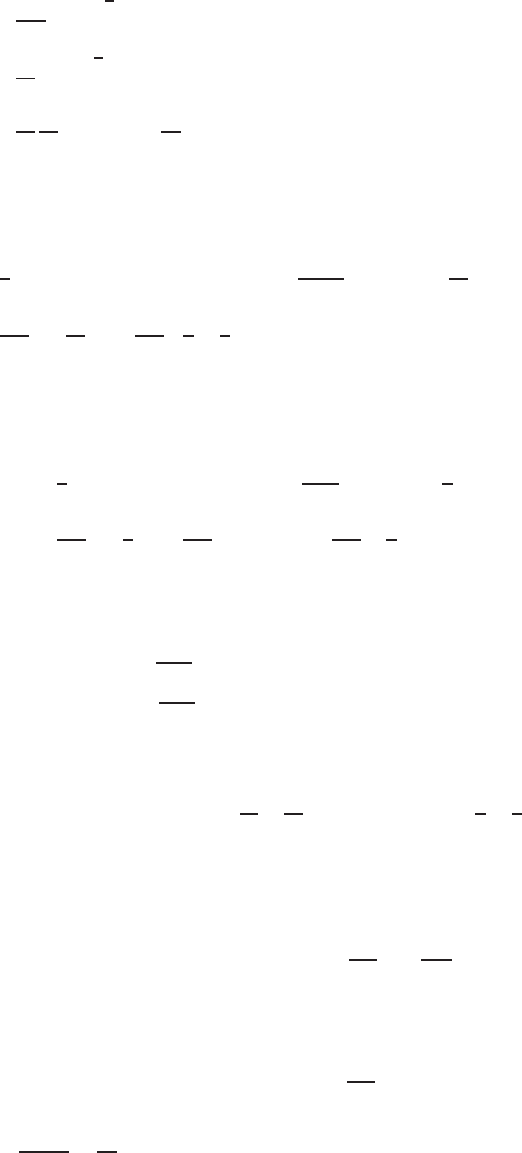
16.5 SOLUTIONS 1547
=3
πa3Za
0Zπ
3
0Z2π
0
ρ4sin3(φ)dθ dφ dρ
=6
a3Za
0Zπ
3
0
ρ4sin3(φ)dφ dρ
=6
a3
5
24 Za
0
ρ4dρ =a2
4.
63. Using spherical coordinates,
Stored energy =1
2Zb
aZπ
0Z2π
0
ǫE2ρ2sin φ dθ dφ dρ =q2
32π2ǫZb
aZπ
0Z2π
0
1
ρ2sin φ dθ dφ dρ
=q2
8πǫ Zb
a
1
ρ2dρ =q2
8πǫ 1
a−1
b.
64. Use cylindrical coordinates, with the z-axis being the axis of the cable. Consider a piece of cable of length 1. Then
Stored energy =1
2Zb
aZ1
0Z2π
0
ǫE2r dθ dz dr =q2
8π2ǫZb
aZ1
0Z2π
0
1
rdθ dz dr
=q2
4πǫ Zb
a
1
rdr =q2
4πǫ (ln b−ln a) = q2
4πǫ ln b
a.
So the stored energy is proportional to ln(b/a)with constant of proportionality q2/4πǫ.
65. The surface z= 4 −x2−y2cuts the xy-plane in the circle x2+y2= 4. Thus
Mass =Z2
−2Z√4−x2
−√4−x2Z4−x2−y2
0
e−x−ydz dy dx gm.
66. The cylinder has radius 2. Using cylindrical coordinates to find the mass and integrating with respect to rfirst, we have
Mass =Z2π
0Z3
0Z2
0
(1 + r)r dr dz dθ =Z2π
0Z3
0r2
2+r3
3
2
0
dz dθ = 2π·3·4
2+8
3= 28πgm.
67. In cylindrical coordinates, the density, δis given by δ=kr for some positive constant k.
For the smaller cylinder, x2+y2≤1,0≤z≤2, whose radius is 1,
Mass =Z2π
0Z2
0Z1
0
kr·r dr dz dθ = 2π·2·kr3
3
1
0
=4πk
3.
For the larger cylinder, x2+y2≤9,0≤z≤2, whose radius is 3,
Mass =Z2π
0Z2
0Z3
0
kr·r dr dz dθ = 2π·2·kr3
3
3
0
= 36πk.
Thus, the ratio of the masses is 4πk/3
36πk =1
27 .
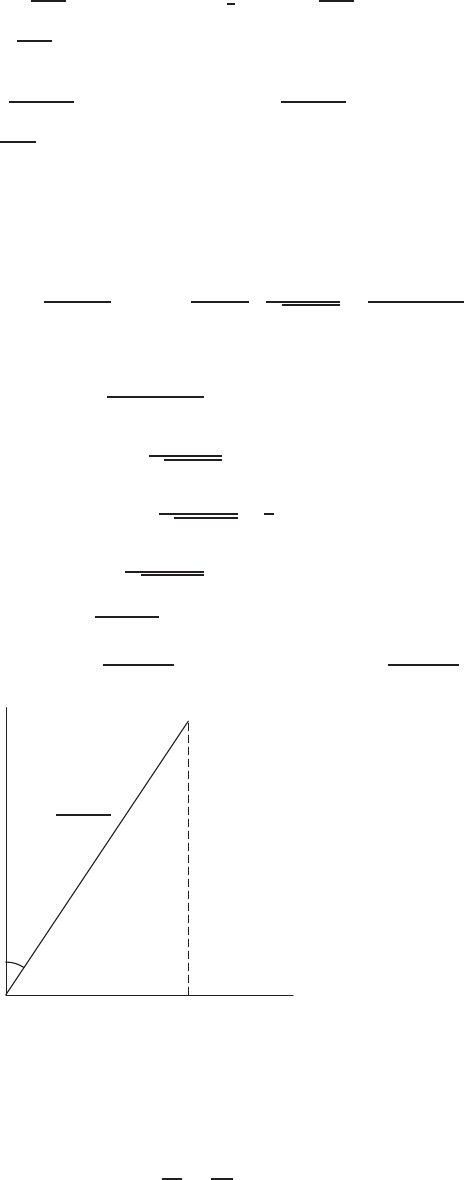
1548 Chapter Sixteen /SOLUTIONS
68. Integrating with respect to zfirst, we have
W=Z1
0Z2π
0Z(√9−r2)−1
√1−r2
r dz dθdr +Z2√2
1Z2π
0Z(√9−r2)−1
0
r dz dθ dr
or integrating with respect to rfirst, we have
Z1
0Z2π
0Z√9−(z+1)2
√1−z2
r dr dθ dz +Z2
1Z2π
0Z√9−(z+1)2
0
r dr dθ dz.
69. Assume the base of the cylinder sits on the xy-plane with center at the origin. Because the cylinder is symmetric about the
z-axis, the force in the horizontal xor ydirection is 0. Thus we need only compute the vertical zcomponent of the force.
We are going to use cylindrical coordinates; since the force is G·mass/(distance)2, a piece of the cylinder of volume
dV located at (r, θ, z)exerts on the unit mass a force with magnitude G(δ dV )/(r2+z2). See Figure 16.116.
Vertical component
of force =G(δ dV )
r2+z2·cos φ=Gδ dV
r2+z2·z
√r2+z2=Gδz dV
(r2+z2)3/2.
Adding up all the contributions of all the dV ’s, we obtain
Vertical force =ZH
0Z2π
0ZR
0
Gδzr
(r2+z2)3/2drdθdz
=ZH
0Z2π
0
(Gδz)−1
√r2+z2
R
0
dθdz
=ZH
0Z2π
0
(Gδz)·−1
√R2+z2+1
zdθdz
=ZH
0
2πGδ 1−z
√R2+z2dz
=2πGδ(z−pR2+z2)
H
0
= 2πGδ(H−pR2+H2+R) = 2πGδ(H+R−pR2+H2)
√r2+z2
z
φ
Figure 16.116
70. The charge density is δ=kz, where kis a constant. In cylindrical coordinates,
Total charge =ZCylinder
δdV =Zh
0ZR
0Z2π
0
kzr dθ dr dz =kZh
0ZR
0
2πzr dr dz
=kπ Zh
0
R2zdz =k(πR2)h2
2=kπ
2R2h2.
Thus, the total charge is proportional to R2h2with constant of proportionality kπ/2.
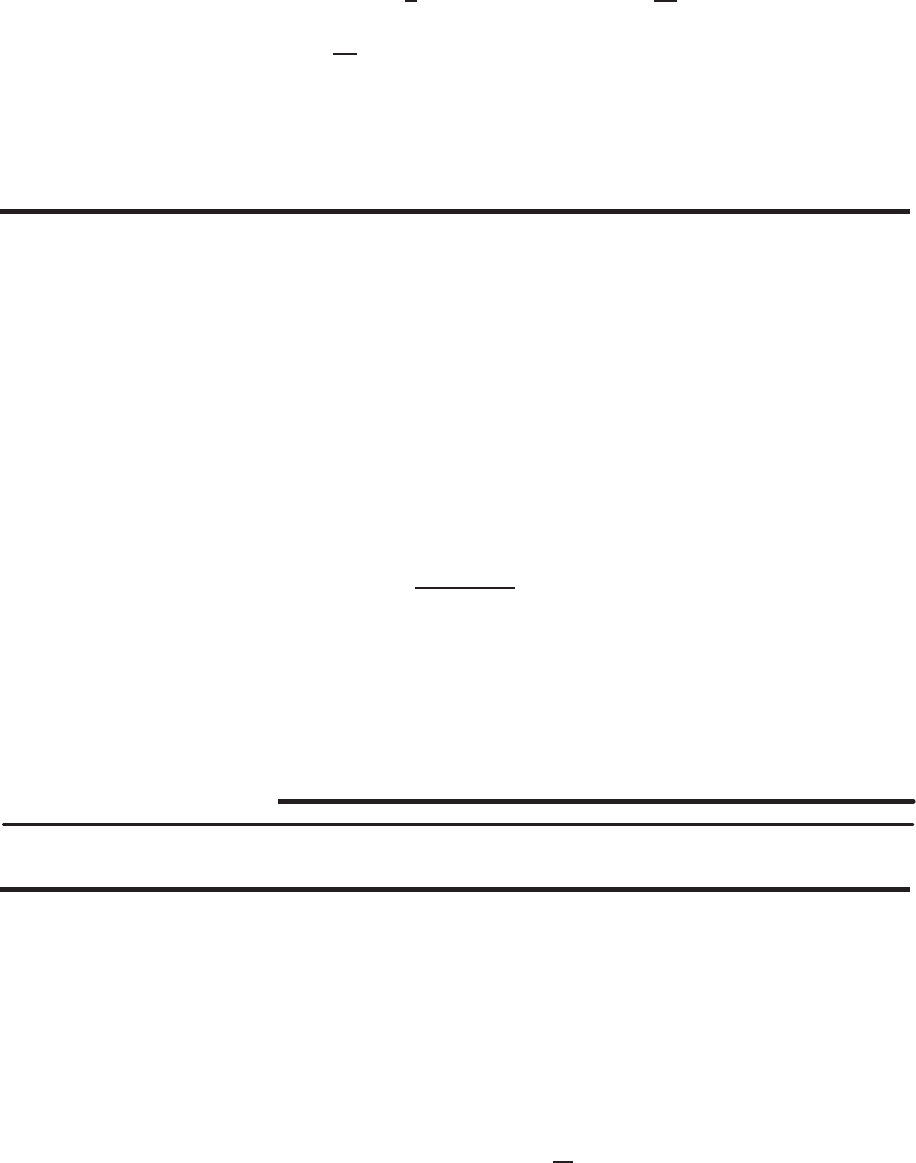
16.6 SOLUTIONS 1549
71. The charge density is δ=k/ρ. Integrating in spherical coordinates,
Total charge =Z2π
0Zπ
0ZR
0
k
ρρ2sin φ dρ dφ dθ =kZ2π
0Zπ
0
R2
2sin φ dφ dθ
= 4πk R2
2= 2πkR2.
Thus, the total charge is proportional to R2with constant of proportionality 2πk.
72. In the system used in this book the volume element is dV =ρ2sin φ dρ dφ dθ. In the system shown in the problem, φ
and θhave been interchanged and ρchanged to r. So the volume element is dV =r2sin θ dr dθ dφ.
Strengthen Your Understanding
73. (c) Zπ
0Z2π
0Z1
0
ρ2sin φ dρ dθ dφ
74. The integral is missing part of the volume element in spherical coordinates. The integral Z2π
0Zπ
0Z1
0
ρ2sin φ dρ dφ dθ
gives the volume inside the sphere of radius 1.
75. We cannot switch the order of integration without rewriting the limits of integration if doing so produces limits that are
not constant on the outer integral.
76. In spherical coordinates, the upper half of a sphere of radius ris given by 0≤ρ≤r,0≤θ≤2πand 0≤φ≤π/2.
Therefore, for a hemisphere of radius 5, we have
Volume =Z2π
0Zπ/2
0Z5
0
ρ2sin φ dρ dφ dθ.
77. Let Wbe the unit ball x2+y2+z2≤1. It is not easy to integrate
ZWpx2+y2+z2dx dy dz.
In spherical coordinates, this integral becomes easy to integrate:
Z2π
0Zπ
0Z1
0
ρρ2sin φ dρ dφ dθ =Z2π
0Zπ
0Z1
0
ρ3sin φ dρ dφ dθ.
Solutions for Section 16.6
Exercises
1. Yes, pis a joint density function. The values of p(x, y)are nonnegative, since p(x, y) = 1/2for all points inside Rand
p(x, y) = 0 for all other points. The volume under the graph of pover the region Ris (1/2)(5 −4)(0 −(−2)) = 1.
2. No, pis not a joint density function. Since p(x, y) = 0 outside the region R, the volume under the graph of pis the same
as the volume under the graph of pover the region R, which is 2not 1.
3. No, pis a not joint density function, because p(x, y)<0for some points (x, y)in the region R. For example,
p(−0.7,0.1) = −0.6.
4. Yes, pis a joint density function. Since x≤yeverywhere in the region R, we have p(x, y) = 6(y−x)≥0for all x
and yin R, and p(x, y) = 0 for all other (x, y). To check that pis a joint density function, we check that the total volume
under the graph of pover the region Ris 1:
ZR
p(x, y)dA =Z1
0Zy
0
6(y−x)dx dy =Z1
0
6yx −x2
2
y
0
dy =Z1
0
3y2dx =y3
1
0
= 1.
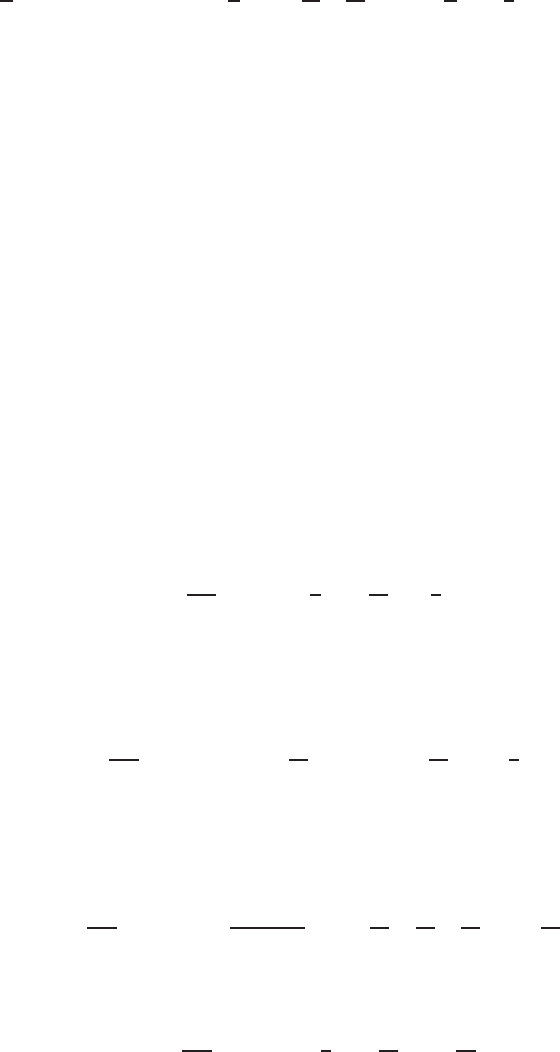
1550 Chapter Sixteen /SOLUTIONS
5. Yes, pis a joint density function. In the region Rwe have 1≥x2+y2, so p(x, y) = (2/π)(1 −x2−y2)≥0for all x
and yin R, and p(x, y) = 0 for all other (x, y). To check that pis a joint density function, we check that the total volume
under the graph of pover the region Ris 1. Using polar coordinates, we get:
ZR
p(x, y)dA =2
πZ2π
0Z1
0
(1 −r2)r dr dθ =2
πZ2π
0r2
2−r4
4
1
0
dθ =2
πZ2π
0
1
4dθ = 1.
6. Yes, pis a joint density function. Since e−x−yis always positive, p(x, y) = xye−x−y≥0for all xand yin R, and
hence for all xand y. To check that pis a joint density function, we check that the total volume under the graph of pover
the region Ris 1. Since e−x−y=e−xe−y, we have
ZR
xye−x−ydA =Z∞
0Z∞
0
xye−x−ydx dy =Z∞
0
ye−yZ∞
0
xe−xdxdy.
Using integration by parts:
Z∞
0
xe−xdx = lim
b→∞(−xe−x−e−x)
b
0
= (0 −0) −(0 −1) = 1.
Thus ZR
xye−x−ydA =Z∞
0
ye−yZ∞
0
xe−xdxdy =Z∞
0
ye−ydy = 1.
7. We have p(x, y) = 0 for all points (x, y)satisfying x≥3, since all such points lie outside the region R. Therefore the
fraction of the population satisfying x≥3is 0.
8. The fraction is 0, since R1
1xy dx = 0, so R∞
−∞ R1
1p(x, y)dx dy =R1
0R1
1xy dx dy=0.
9. Since x+y≤3for all points (x, y)in the region R, the fraction of the population satisfying x+y≤3is 1.
10. Since p(x, y) = 0 for any (x, y)with x < 0and also p(x, y) = 0 for any (x, y)with y > 1or y < 0, the fraction of the
population is given by the double integral:
Z1
0Z1
0
xy dx dy =Z1
0
x2y
2
1
0
dy =Z1
0
y
2dy =y2
4
1
0
=1
4.
11. Since p(x, y) = 0 for all (x, y)outside the rectangle R, the population is given by the volume under the graph of pover
the region inside the rectangle Rand to the right of the line x=y. Therefore the fraction of the population is given by
the double integral:
Z1
0Z2
y
xy dx dy =Z1
0
x2y
2
2
y
dy=Z1
02y−y3
2dy =y2−y4
8
1
0
=7
8.
12. Since p(x, y) = 0 for all (x, y)outside the rectangle R, the population is given by the volume under the graph of pover
the region inside the rectangle Rand below the line x+y= 1. This is the same as the region bounded by the x-axis, the
y-axis, and the line x+y= 1. Therefore the fraction of the population is given by the double integral:
Z1
0Z1−y
0
xy dx dy =Z1
0
x2y
2
1−y
0
dy =Z1
0
(1 −y)2y
2dy =y2
4−y3
3+y4
8
1
0
=1
24 .
13. The fraction of the population is given by the double integral:
Z1/2
0Z1
0
xy dx dy =Z1/2
0
x2y
2
1
0
dy=Z1/2
0
y
2dy =y2
4
1/2
0
=1
16 .
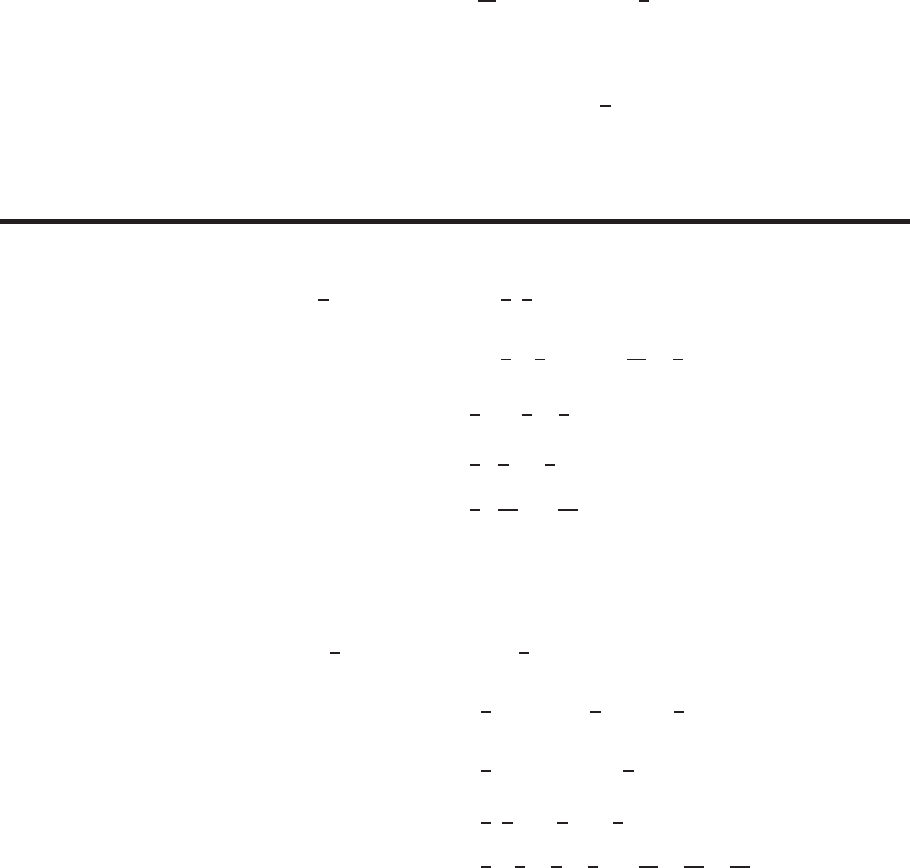
16.6 SOLUTIONS 1551
14. We are looking for points inside the circle x2+y2= 1 and inside the rectangle R. In the first quadrant, all of the circle
and its interior lies inside the rectangle R. Thus the fraction of the population we want is given by the volume under the
graph of pover the region inside the circle x2+y2= 1 in the first quadrant. We evaluate this double integral using polar
coordinates:
Zπ/2
0Z1
0
(rcos θ)(rsin θ)r dr dθ =Zπ/2
0
r4
4cos θsin θ
1
0
dθ =1
4Zπ/2
0
cos θsin θ dθ.
Making the substitution w= sin θ, we get:
Zπ/2
0
cos θsin θ dθ =Z1
0
w dw =1
2.
Thus the fraction is (1/4)(1/2) = 1/8.
Problems
15. (a)
Z1
0Z1
1/3
2
3(x+ 2y)dx dy =Z1
0
2
3(1
2x2+ 2xy)1
1/3dy
=Z1
0
2
3h(1
2+ 2y)−(1
18 +2
3y)idy
=2
3Z1
0
(4
9+4
3y)dy
=2
34
9y+2
3y21
0
=2
310
9=20
27 .
(b) It is easier to calculate the probability that x < (1/3)+ydoes not happen, that is, the probability that x≥(1/3)+y,
and subtract it from 1. The probability that x≥(1/3) + yis
Z1
1/3Zx−(1/3)
0
2
3(x+ 2y)dy dx =Z1
1/3
2
3(xy +y2)x−(1/3)
0dx
=2
3Z1
1/3
(x(x−1
3) + (x−1
3)2)dx
=2
3Z1
1/3
(2x2−x+1
9)dx
=2
3(2
3x3−1
2x2+1
9x)1
1/3
=2
3h(2
3−1
2+1
9)−(2
81 −1
18 +1
27 )i
= 44/243.
Thus, the probability that x < (1/3) + yis 1−(44/243) = 199/243.

1552 Chapter Sixteen /SOLUTIONS
1
3
x < 1
3+y
Figure 16.117
16. (a) We know that R∞
−∞R∞
−∞ f(x, y)dydx = 1 for a joint density function. So,
1 = Z∞
−∞Z∞
−∞
f(x, y)dydx =Z1
0Z1
x
kxydydx
=1
8k
hence k= 8.
(b) The region where x < y < √xis sketched in Figure 16.118
1
0
1
x
yy=x
y=√x
Figure 16.118
So the probability that (x, y)satisfies x < y < √xis given by:
Z1
0Z√x
x
8xy dy dx =Z1
0
4x(y2)√x
xdx
=Z1
0
4x(x−x2)dx
= 4 1
3x3−1
4x4
1
0
=41
3−1
4
=1
3
This tells us that in choosing points from the region defined by 0≤x≤y≤1, that 1/3of the time we would
pick a point from the region defined by x < y < √x. These regions are shown in Figure 16.118.
17. (a) For a density function,
1 = Z∞
−∞ Z∞
−∞
f(x, y)dy dx =Z2
0Z1
0
kx2dy dx

16.6 SOLUTIONS 1553
=Z2
0
kx2dx
=kx3
32
0=8k
3.
So k= 3/8.
(b) Z1
0Z2−y
0
3
8x2dx dy =Z1
0
1
8(2 −y)3dy =−1
32 (2 −y)41
0=15
32
(c) Z1/2
0Z1
0
3
8x2dx dy =Z1/2
0
1
8x31
0dy =Z1/2
0
1
8dy =1
16 .
18. (a) The area of Sis (2)(4) = 8. Because the density function p(x, y)is constant on Sand the total volume under a
density function above the xy-plane is 1,p(x, y) = 1/8for (x, y)in S, and p(x, y) = 0 for (x, y)outside S.
(b) The probability that (x, y)is in Tis
ZT
f(x, y)dy dx =1
8ZT
dy dx =area(T)
8=α
8.
19. Since X
xX
y
f(x, y) ∆x∆y≈ZR
f(x, y)dx dy
and since xnever exceeds 1, and we can assume that no one lives to be over 100, so ydoes not exceed 100, we have
Fraction of
policies =ZR
f(x, y)dx dy =Z100
65 Z1
0.8
f(x, y)dx dy,
where Ris the rectangle: 0.8≤x≤1,65 ≤y≤100.
20. (a) Since the exponential function is always positive and λis positive, p(t)≥0for all t, and
Z∞
0
p(t)dt= lim
b→∞ −e−λt
b
0
= lim
b→∞ −e−bt + 1 = 1.
(b) The density function for the probability that the first substance decays at time tand the second decays at time sis
p(t, s) = λe−λtµe−µs =λµe−λt−µs,
for s≥0and t≥0, and is zero otherwise.
(c) We want the probability that the decay time tof the first substance is less than or equal to the decay time sof the
second, so we want to integrate the density function over the region 0≤t≤s. Thus, we compute
Z∞
0Z∞
t
λµe−λte−µs ds dt =Z∞
0
λe−λt(−e−µs)∞
tdt
=Z∞
0
λe−λte−µt dt
=Z∞
0
λe(−λ+µ)tdt
=−λ
λ+µe−(λ+µ)t∞
0=λ
λ+µ.
So for example, if λ= 1 and µ= 4, then the probability that the first substance decays first is 1/5.
21. (a) Zπ
6
θ=0Z4
r=1
cos θ
p(r, θ)r dr dθ
(b)
Zπ
6+π
12
θ=π
6Z4
r=1
cos θ
p(r, θ)r dr dθ +Z2π
6
θ=π
6+π
12 Z4
r=1
sin θ
p(r, θ)r dr dθ
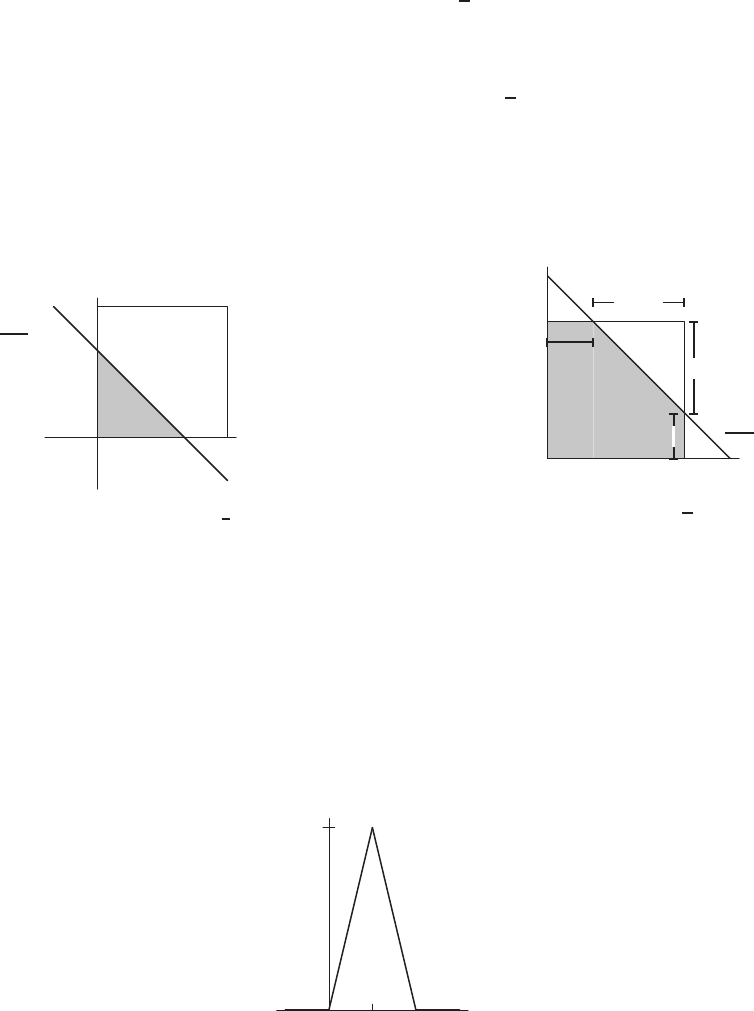
1554 Chapter Sixteen /SOLUTIONS
22. (a) If t≤0, then F(t) = 0 because the average of two positive numbers can not be negative. If 1< t then F(t) = 1
because the average of two numbers each at most 1 is certain to be less than or equal to 1. For any t, we have
F(t) = RRp(x, y)dA where Ris the region of the plane defined by (x+y)/2≤t. Since p(x, y) = 0 outside the
unit square, we need integrate only over the part of Rthat lies inside the square, and since p(x, y) = 1 inside the
square, the integral equals the area of that part of the square. Thus, we can calculate the area using area formulas.
For 0≤t≤1, we draw the line (x+y)/2 = t, which has x- and y-intercepts of 2t. Figure 16.119 shows that for
0< t ≤1/2,
F(t) = Area of triangle =1
2·2t·2t= 2t2.
In Figure 16.120, when x= 1, we have y= 2t−1. Thus, the vertical side of the unshaded triangle is 1−(2t−1) =
2−2t. The horizontal side is the same length, so for 1/2< t ≤1,
F(t) = Area of Square −Area of triangle = 12−1
2(2 −2t)2−1−2(1 −t)2.
The final result is:
F(t) =
0if t≤0
2t2if 0< t ≤1/2
1−2(1 −t)2if 1/2< t ≤1
1if 1< t
.
1
2t
1
2t
x+y
2=t
x
y
Figure 16.119
: For 0< t ≤1
2
1 2t
2t
1
x+y
2=t
✲✛ 2−2t
✲✛
2t−1
✻
❄
2−2t
✻
❄
2t−1
x
y
Figure 16.120
: For 1
2< t ≤1
(b) The probability density function p(t)of zis the derivative of its cumulative distribution function. We have
p(t) =
0ift≤0
4tif 0< t ≤1/2
4−4tif 1/2< t ≤1
0if 1< t
.
See Figure 16.121.
(c) The values of xand yand equally likely to be near 0,1/2, and 1. Notice from the graph of the density function in
Figure 16.121 that even though xand yseparately are equally likely to be anywhere between 0 and 1, their average
z= (x+y)/2is more likely to be near 1/2than to be near 0 or 1.
0.5 1
2
0
x
p(t)
Figure 16.121
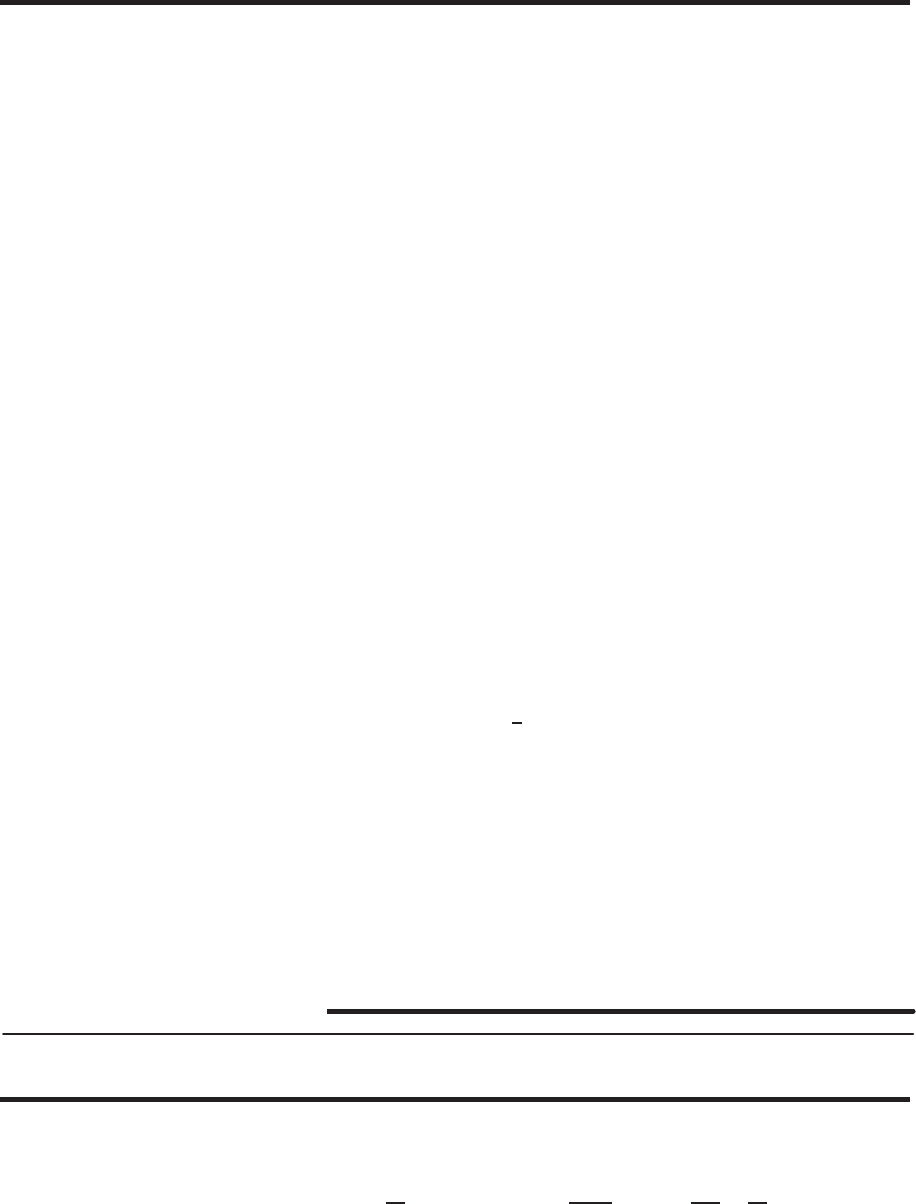
SOLUTIONS to Review Problems for Chapter Sixteen 1555
Strengthen Your Understanding
23. Since p1(x, y)and p2(x, y)are joint density functions, we have
Z∞
−∞Z∞
−∞
p1(x, y)dx dy = 1 and Z∞
−∞ Z∞
−∞
p2(x, y)dx dy = 1.
Thus,
Z∞
−∞ Z∞
−∞
(p1(x, y) + p2(x, y)) dx dy =Z∞
−∞ Z∞
−∞
p1(x, y)dx dy +Z∞
−∞ Z∞
−∞
p2(x, y)dx dy = 1 + 1 = 2.
So p1(x, y) + p2(x, y)is not a joint density function.
24. The value of p(60,170) cannot be interpreted as a probability. The probability that wfalls in the interval of width ∆w
around 60 and hfalls in the interval of width ∆haround 170 is approximately p(60,170)∆w∆h.
25. In order for f(x, y)to be a joint density function, we need
Z∞
−∞Z∞
−∞
f(x, y)dx dy = 1.
Since Z∞
−∞ Z∞
−∞
f(x, y)dx dy =Zd
cZb
a
1dx dy = (b−a)(d−c),
one possibility is a= 0, b = 1, c = 0, d = 1.
26. In order for f(x, y)to be a joint density function, we need
Z∞
−∞Z∞
−∞
f(x, y)dx dy = 1.
We have Z∞
−∞Z∞
−∞
f(x, y)dx dy =Z1
0Z2
0
g(y)dx dy = 2 Z1
0
g(y)dy.
Since Z1
0
y dy =1
2,
one possibility is g(y) = y.
27. True. Since yranges from −∞ to ∞the double integral gives the probability that a≤x≤bby the definition of joint
density function.
28. False. For p(x, y)to be a joint density function one of the restrictions we have is that p(x, y)≥0for all xand y.
29. False. The double integral Zb
aZ∞
−∞
p(x, y)dy dx is the probability that a≤x≤b.
30. True. This follows by the definition of the joint density function.
Solutions for Chapter 16 Review
Exercises
1. The region of integration ranges from x= 0 to x= 3 and from y= 0 to y= 2x, as shown in Figure 16.122. To evaluate
the integral, we evaluate the inside integral first:
Z2x
0
(x2+y2)dy =x2y+y3
3
y=2x
y=0
=x2(2x) + (2x)3
3= 2x3+8x3
3=14
3x3.

1556 Chapter Sixteen /SOLUTIONS
Therefore, we have Z3
0Z2x
0
(x2+y2)dydx =Z3
014
3x3dx =14
12 x4
3
0
= 94.5.
3
6y= 2x
x
y
Figure 16.122
2. The region of integration ranges from x= 0 to x=πand from y= 0 to y=x, as shown in Figure 16.123.
π
π
y=x
x
y
Figure 16.123
Integrating with respect to yfirst
Zπ
0Zx
0
sin x dy dx =Zπ
0
ysin x
x
0
dx =Zπ
0
xsin x dx.
Using integration by parts with u=x,v′= sin x, so u′= 1,v=−cos x, we have
Zπ
0Zx
0
sin x dy dx =Zπ
0
xsin x dx =−xcos x
π
0
+Zπ
0
cos x dx
=−π(−1) + sin x
π
0
=π.
3. See Figure 16.124.
Z0
−2Z0
−√9−x2
2xy dydx =Z0
−2
x y2
0
−√9−x2
dx
=−Z0
−2
x(9 −x2)dx

SOLUTIONS to Review Problems for Chapter Sixteen 1557
=Z0
−2
(x3−9x)dx
=x4
4−9
2x2
0
−2
=−4+ 18 = 14
−3−2 3
−3
3
x
y
❘
x2+y2= 9
Figure 16.124
4. See Figure 16.125.
−1 1
−1
1
x
y
✠
x2+y2= 1
Figure 16.125
5. See Figure 16.126.
−2
2
x
y
✲
x2+y2= 4
Figure 16.126

1558 Chapter Sixteen /SOLUTIONS
6. See Figure 16.127.
y= 1
y= 4
x=√yx =−√y
x
y
Figure 16.127
7. See Figure 16.128.
1
π
2
x
y
y= sin x
or
x= sin−1y
Figure 16.128
8. The region is the half cylinder in Figure 16.129.
11
1
x
y
z
Figure 16.129
9. The region of integration shown in Figure 16.130 is a three-sided pyramid bounded by the xy-plane and the planes y= 1,
z−x= 0 and y−x= 0.
x
y
z
(1,1,0)
(0,1,0)
(1,1,1)
✒
Plane
y=x
✠
Plane
y= 1
Figure 16.130

SOLUTIONS to Review Problems for Chapter Sixteen 1559
10. We use Cartesian coordinates, oriented so that the cube is in the first quadrant. See Figure 16.131. Then, if fis an arbitrary
function, the integral is Z2
0Z3
0Z5
0
f dx dy dz.
Other answers are possible. In particular, the order of integration can be changed.
x
y
z
5
(5,3,0)
(5,3,2)
2
Figure 16.131
11. If we imagine the disk lying horizontally, as in Figure 16.132, we can use cylindrical coordinates with the origin at the
center of the flat base. Then, if fis an arbitrary function, the triple integral is
Z2π
0Z2
0Z3
0
fr drdzdθ.
x
y
z
✻
❄
2
cm
✛
✛
3
cm
Figure 16.132
12. We use spherical coordinates as in Figure 16.133. Then if fis an arbitrary function, the triple integral is
Z2π
0Zπ
π/2Z5
2
fρ2sin φ dρdφdθ.
Other answers are possible.
x
y
z
25
Figure 16.133

1560 Chapter Sixteen /SOLUTIONS
13. We use spherical coordinates, as in Figure 16.134. Then if fis an arbitrary function, the triple integral is
Zπ/2
0Zπ
0Z5
0
fρ2sin φ dρdφdθ.
Other answers are possible.
x
y
z
5
−5
5
0
Figure 16.134
14. Integrating with respect to xfirst we get Z4
0Z−y+4
y
2−2
f(x, y)dx dy
Integrating with respect to yfirst we get
Z0
−2Z2x+4
0
f(x, y)dy dx +Z4
0Z−x+4
0
f(x, y)dy dx.
See Figure 16.135
−2 4
4
x
y
R
y= 2x+ 4
or
x=y
2−2y=−x+ 4
or
x=−y+ 4
Figure 16.135
15. (a) See Figure 16.136.
2
4
x
y
x=−(y−4)/2
or
y=−2x+ 4
Figure 16.136
(b) R2
0R−2x+4
0g(x, y)dy dx.
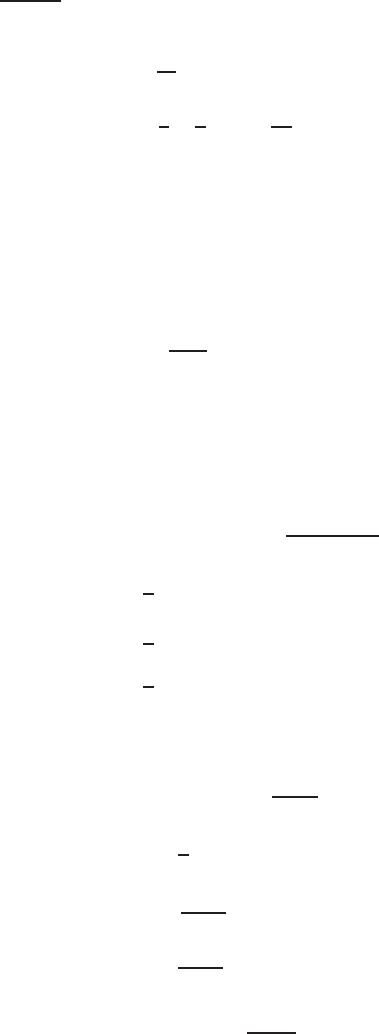
SOLUTIONS to Review Problems for Chapter Sixteen 1561
16. Compute in polar coordinates:
ZRpx2+y2dA =Zπ
0Z2
1
r·r dr dθ
=Zπ
0r3
32
1
dθ
=Zπ
08
3−1
3dθ =7π
3.
17.
Z10
0Z0.1
0
xexy dy dx =Z10
0
exy|0.1
0dx
=Z10
0
(e0.1x−e0)dx
=e0.1x
0.1−x
10
0
= (10e1−10 −10e0)
= 10e−20 = 10(e−2).
18.
Z1
0Z4
3
(sin(2 −y)) cos (3x−7) dx dy =Z1
0
(sin (2 −y)) sin (3x−7)
3
4
3
dy
=1
3(sin 5 −sin 2) Z1
0
sin (2 −y)dy
=1
3(sin 5 −sin 2) [cos (2 −y)]1
0
=1
3(sin 5 −sin 2)(cos 1 −cos 2).
19.
Z1
0Zy
0
(sin3x)(cos x)(cos y)dx dy =Z1
0
(cos y)sin4x
4
y
0
dy
=1
4Z1
0
(sin4y)(cos y)dy
=sin5y
20
1
0
=sin51
20 .
20. First use integration by parts, with yas the variable, u=x2y,u′=x2,v=sin (xy)
x,v′= cos (xy). Then,
Z4
3Z1
0
x2ycos (xy)dy dx =Z4
3[xy sin (xy)]1
0−Z1
0
xsin (xy)dydx
=Z4
3xsin x+ [cos (xy)]1
0dx
=Z4
3
(xsin x+ cos x−1) dx.
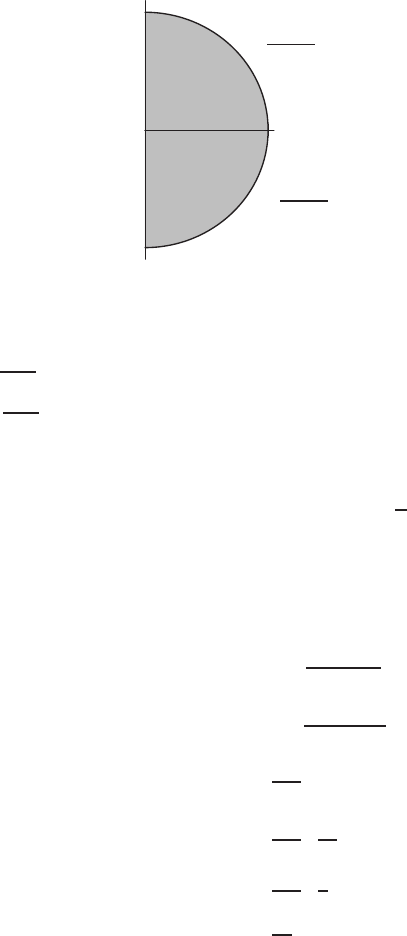
1562 Chapter Sixteen /SOLUTIONS
Now use integration by parts again, with u=x,u′= 1,v=−cos x,v′= sin x. Then,
Z4
3
(xsin x+ cos x−1) dx = [−xcos x]4
3+Z4
3
cos x dx +Z4
3
(cos x−1) dx
= (−xcos x+ 2 sin x−x)|4
3
=−4 cos 4 + 2 sin 4 + 3 cos 3 −2 sin 3 −1.
Thus, Z4
3Z1
0
x2ycos (xy)dy dx =−4 cos 4 + 2 sin 4 + 3 cos 3 −2 sin 3 −1.
21. The region is shown in Figure 16.137.
1
−1
0
1
x
y
√1−x2
−√1−x2
Figure 16.137
The integral has the same values in the upper and lower quarter circles, so we integrate over just the upper circle and
multiply by 2. We convert the integral to polar coordinates.
Z1
0Z√1−x2
−√1−x2
e−(x2+y2)dy dx = 2 Zπ/2
0Z1
0
e−r2r dr dθ =Zπ/2
0
(−e−r2)
1
0
dθ
=Zπ/2
0
1−e−1dθ
=π
2(1 −e−1).
22.
Z1
0Zz
0Z2
0
(y+z)7dx dy dz =Z1
0Zz
0
2(y+z)7dy dz
=Z1
0
2(y+z)8
8
z
0
dz
=Z1
0
(2z)8−z8
4dz
=255
4Z1
0
z8dz
=255
4z9
91
0
=255
4·1
9
=85
12 .
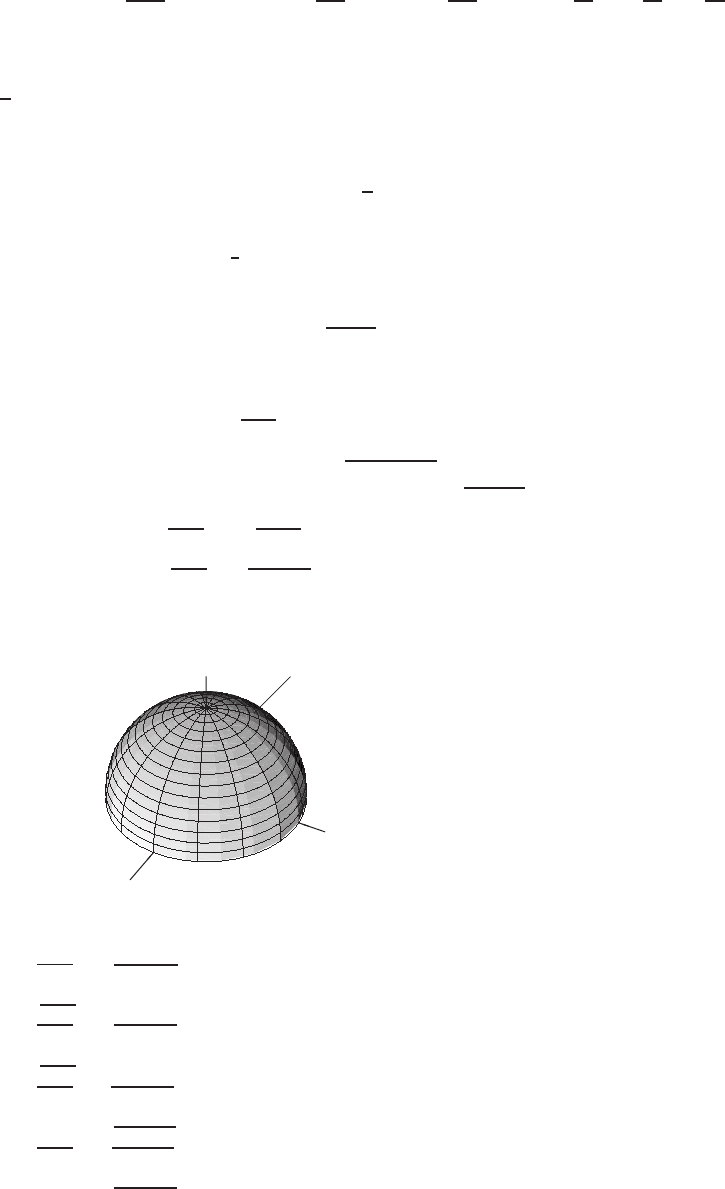
SOLUTIONS to Review Problems for Chapter Sixteen 1563
23. Evaluating gives
Z1
0Zz
0Zy
0
xyz dx dy dz =Z1
0Zz
0
x2yz
2
y
0
dy dz =Z1
0Zz
0
y3z
2dy dz =Z1
0
y4z
8
z
0
dz=Z1
0
z5
8dz =z6
48
1
0
=1
48 .
24. (a) A vertical plane perpendicular to the x-axis: x= 2.
(b) A cylinder: r= 3.
(c) A sphere: ρ=√3.
(d) A cone: φ=π/4.
(e) A horizontal plane: z=−5.
(f) A vertical half-plane: θ=π/4.
25. In spherical coordinates, the spherical cap is part of the surface ρ=√2. If αis the angle at the vertex of the cone, we
have tan(α/2) = 2/2 = 1, so α/2 = π/4. Since the cone is below the xy-plane, the angle φranges from 3π/4to π.
Thus, the integral is given by
Z2π
0Zπ
3π/4Z√2
0
f(ρ, φ, θ)ρ2sin φ dρ dφ dθ.
26. In cylindrical coordinates, the spherical cap has equation z=−√2−r2. If αis the angle at the vertex of the cone, we
have tan(α/2) = 2/2 = 1, so α/2 = π/4. The cone has equation z=−r. Thus, the integral is
Z2π
0Z1
0Z−r
−√2−r2
g(r, θ, z)r dz dr dθ.
27. In rectangular coordinates, the spherical cap has equation z=−p2−x2−y2. If αis the angle at the vertex of the
cone, we have tan(α/2) = 2/2 = 1, so α/2 = π/4. The cone has equation z=−px2+y2. Thus, the integral is
Z1
−1Z√1−x2
−√1−x2Z−√x2+y2
−√2−x2−y2
h(x, y, z)dz dy dx.
28. From Figure 16.138, we have the following iterated integrals:
x
y
z
✠
x2+y2+z2= 1
Figure 16.138
(a) ZR
f dV =Z1
−1Z√1−x2
−√1−x2Z√1−x2−y2
0
f(x, y, z)dz dy dx
(b) ZR
f dV =Z1
−1Z√1−y2
−√1−y2Z√1−x2−y2
0
f(x, y, z)dz dx dy
(c) ZR
fdV =Z1
−1Z√1−y2
0Z√1−y2−z2
−√1−y2−z2
f(x, y, z)dx dz dy
(d) ZR
f dV =Z1
−1Z√1−x2
0Z√1−x2−z2
−√1−x2−z2
f(x, y, z)dy dz dx
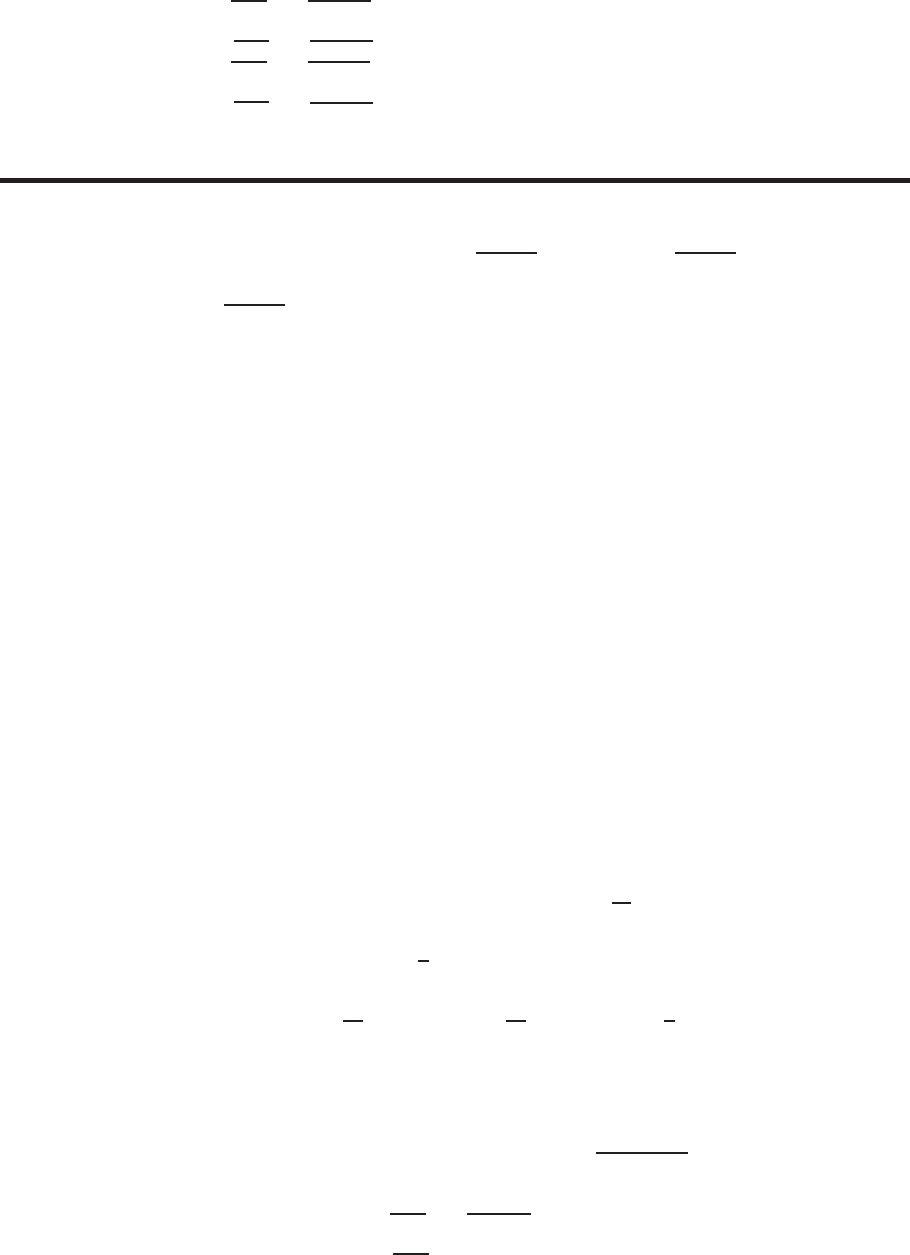
1564 Chapter Sixteen /SOLUTIONS
(e) ZR
f dV =Z1
0Z√1−z2
−√1−z2Z√1−x2−z2
−√1−x2−z2
f(x, y, z)dy dx dz
(f) ZR
fdV =Z1
0Z√1−z2
−√1−z2Z√1−y2−z2
−√1−y2−z2
f(x, y, z)dx dy dz
Problems
29. Positive. The value of xis positive on the half-cone, so its integral is positive.
30. Positive. Since zis positive on W, its integral is positive.
31. Positive. If (x, y, z)is any point inside the solid Wthen px2+y2< z. Thus z−px2+y2>0, and so its integral
over the solid Wis positive.
32. Positive. The function px2+y2is positive, so its integral over the solid Wis positive.
33. Negative. If (x, y, z)is any point inside the cone then z < 2. Hence the function z−2is negative on Wand so is its
integral.
34. Zero. yis positive on the half of the half-cone above the first quadrant in the xy-plane and negative (of equal absolute
value) on the half of the half-cone above the fourth quadrant. The integral of yover Wis zero because the integrals over
each half add up to zero.
35. Zero. You can see this in several ways. One way is to observe that xy is positive on part of the cone above the first
quadrant (where xand yare of the same sign) and negative (of equal absolute value) on the part of the cone above the
fourth quadrant (where xand yhave opposite signs). These add up to zero in the integral of xy over all of W.
Another way to see that the integral is zero is to write the triple integral as an iterated integral, say integrating first
with respect to y. For fixed xand z, the y-integral is over an interval symmetric about 0. The integral of yover such an
interval is zero. If any of the inner integrals in an iterated integral is zero, then the triple integral is zero.
36. Zero. Write the triple integral as an iterated integral, say integrating first with respect to y. For fixed xand z, the y-integral
is over an interval symmetric about 0. The integral of yover such an interval is zero. If any of the inner integrals in an
iterated integral is zero, then the triple integral is zero.
37. Positive. The function e−xyz is a positive function everywhere so its integral over Wis positive.
38. (a) The top of the tetrahedron is z=x−y+ 2, and its triangular base is in the second quadrant of the xy-plane bounded
by the x- and y-axes, and the line 0 = x−y+ 2, or y= 2 + x. Thus the volume is given by
V=Z0
−2Z2+x
0Zx−y+2
0
dz dy dx.
Other orders of integration are possible.
(b) Evaluating gives
V=Z0
−2Z2+x
0
(x−y+2) dy dx =Z0
−2
xy −y2
2+ 2y
2+x
0
dx
=Z0
−2
x(2 + x)−1
2(2 + x)2+ 2(2 + x)dx
=Z0
−2x2
2+ 2x+ 2dx =x3
6+x2+ 2x
0
−2
=4
3.
39. (a) Since zis positive above the xy-plane and negative below the xy-plane, the contributions to RBdV and RRzdV
cancel; both these integrals are zero. Hence (i) and (iii) are zero.
The integral RTzis positive.
(b) The equation of the sphere is x2+y2+z2= 1, so the top half is z=p1−x2−y2. Thus, integrating with respect
to zfirst, we have
ZT
zdV =Z1
−1Z√1−x2
−√1−x2Z√1−x2−y2
0
z dz dy dx
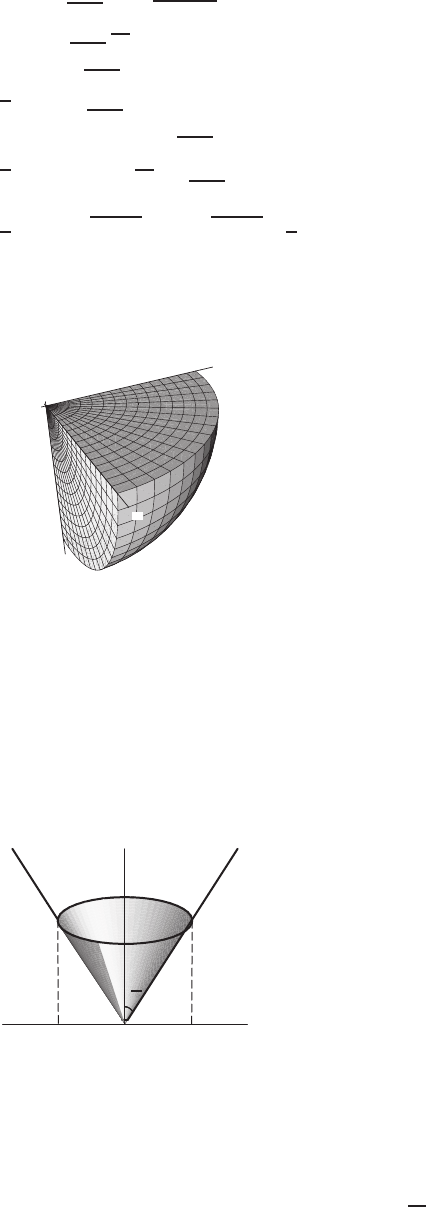
SOLUTIONS to Review Problems for Chapter Sixteen 1565
=Z1
−1Z√1−x2
−√1−x2
z2
2
√1−x2−y2
0
dy dx
=1
2Z1
−1Z√1−x2
−√1−x2
(1 −x2−y2)dy dx
=1
2Z1
−1
y−x2y−y3
3
√1−x2
−√1−x2
dx
=1
2Z1
−12p1−x2−2x2p1−x2+2
3(1 −x2)3/2dx
= 1.571
40. Ris one eighth of a sphere of radius 1, below the xy-plane and under the first quadrant. See Figure 16.139.
x
y
z
Figure 16.139
41. (a) The region of integration is the region between the cone z=r, the xy-plane and the cylinder r= 3. In spherical
coordinates, r= 3 becomes ρsin φ= 3, so ρ= 3/sin φ. The cone is φ=π/4and the xy-plane is φ=π/2. See
Figure 16.140. Thus, the integral becomes
Z2π
0Zπ/2
π/4Z3/sin φ
0
ρ2sin φ dρdφdθ.
x
z
3
r= 3
z=r
π
4
Figure 16.140
: Region of integration is
between the cone and the xy-plane
(b) The original integral is easier to evaluate, so
Z2π
0Z3
0Zr
0
rdzdrdθ =Z2π
0Z3
0
zr
z=r
z=0
drdθ =Z2π
0Z3
0
r2drdθ = 2π·r3
3
3
0
= 18π.
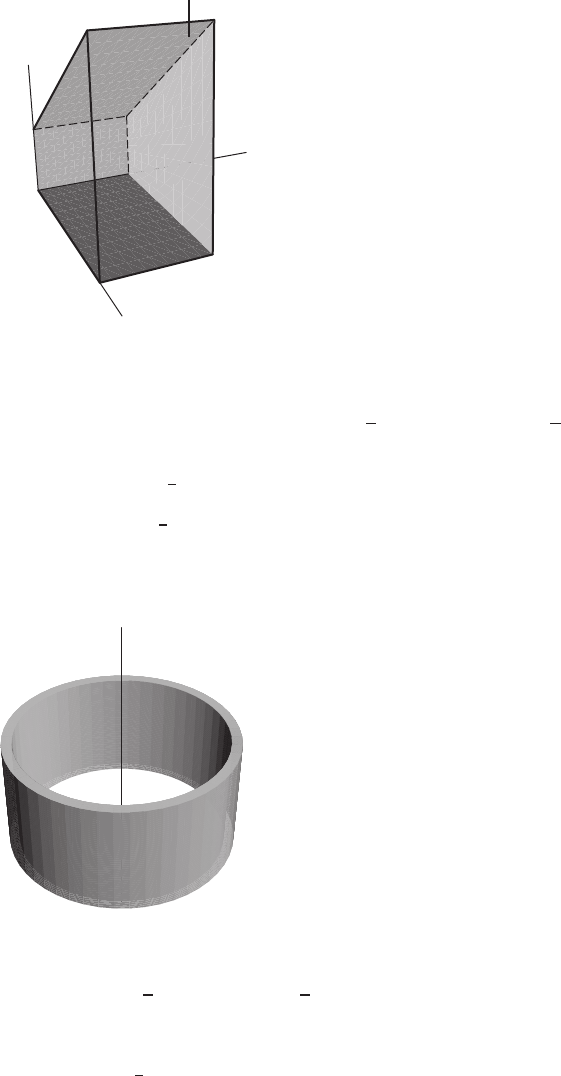
1566 Chapter Sixteen /SOLUTIONS
42. The region stands on a rectangular base in the xy-plane, with vertical sides and a slanting top, the plane z= 1 + x. See
Figure 16.141. The integral is Z2
0Z1
0Z1+x
0
f(x, y, z)dz dy dx.
The order of integration can be altered.
x
y
z
1
2
❄
z= 1 + x
Figure 16.141
43. The region is a solid ring between the planes z= 2 and z= 3, with inner radius r=√5and outer radius r=√6. See
Figure 16.142. In cylindrical coordinates, the integral is
Z2π
0Z3
2Z√6
√5
r dr dz dθ.
The order of integration can be changed.
z
z= 3
z= 2
Figure 16.142
44. The region is a hollow half-sphere, with inner radius √3and outer radius √4 = 2. See Figure 16.143. In spherical
coordinates, the integral is Zπ
0Zπ
0Z2
√3
ρ2sin φ dρ dφ dθ.
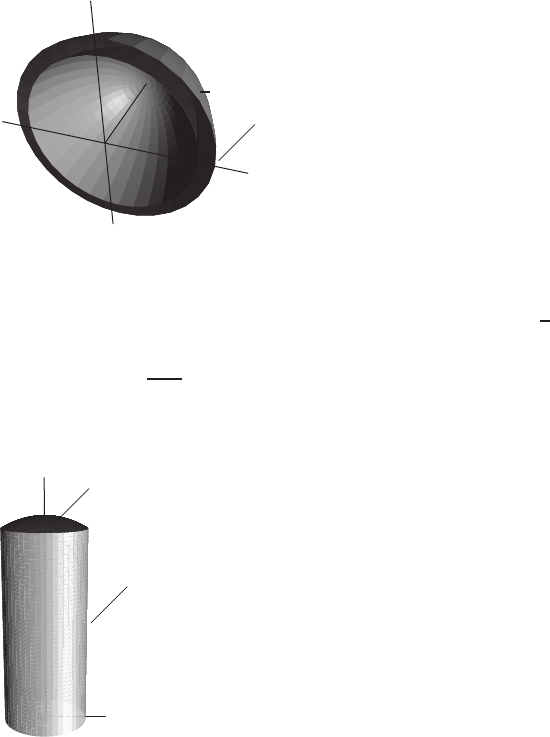
SOLUTIONS to Review Problems for Chapter Sixteen 1567
The order of integration can be altered.
x
y
z
❄
√3
✠
2
Figure 16.143
45. The region stands on a circular base of radius 1 in the xy-plane and has cylindrical sides. The top is part of a sphere of
radius 3. The cylinder meets the sphere where x2+y2= 1 and x2+y2+z2= 9, so 1 + z2= 9,z=√8. See
Figure 16.144. In cylindrical coordinates, the integral is
Z2π
0Z1
0Z√9−r2
0
rdz dr dθ.
x
z
✠
Sphere:
x2+y2+z2= 9
✠
Cylinder:
x2+y2= 1
Figure 16.144
46. Positive, since e−xis always positive.
47. Negative, since y3is negative on B, where y < 0.
48. Positive, since (x+y2)is positive on R, where x > 0.
49. Can’t tell, since y3is both positive and negative for x < 0.
50. Can’t tell, since x < 0and y2≥0on L, where x < 0.
51. Zero. The solid sphere is symmetric and zis positive on the top half and negative (of equal absolute value) on the bottom
half. The integral of zover the entire solid is zero because the integrals over each half add up to zero.
52. Zero. xis positive on the hemisphere x2+y2+z2≤1,x > 0and negative (of equal absolute value) on x2+y2+z2≤1,
x < 0. The integral of xover the entire solid is zero because the integrals over each half add up to zero.
53. Zero. You can see this in several ways. One way is to observe that xy is positive on the part of the sphere above and below
the first and third quadrants (where xand yare of the same sign) and negative (of equal absolute value) on the part of the
sphere above and below the second and fourth quadrants (where xand yhave opposite signs). These add up to zero in the
integral of xy over all of W.
Another way to see that the integral is zero is to write the triple integral as an iterated integral, say integrating first
with respect to x. For fixed yand z, the x-integral is over an interval symmetric about 0. The integral of xover such an
interval is zero. If any of the inner integrals in an iterated integral is zero, then the triple integral is zero.
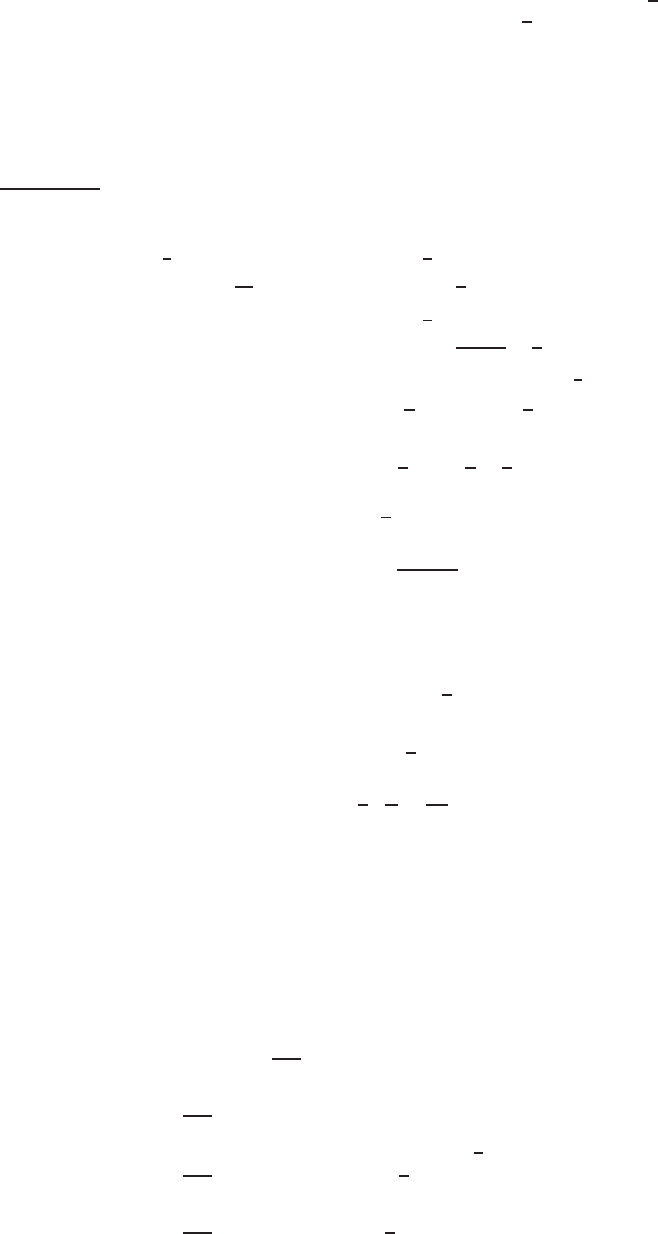
1568 Chapter Sixteen /SOLUTIONS
54. Zero. Write the triple integral as an iterated integral, say integrating first with respect to x. Then sin( π
2xy)is integrated
over an integral symmetric about the origin, and this integral is zero because sin( π
2xy)is an odd function. Since the
innermost integral is zero so is the triple integral.
55. Zero. Write the triple integral as an iterated integral, say integrating first with respect to x. For fixed yand z, the x-integral
is over an interval symmetric about 0. The integral of xover such an interval is zero. If any of the inner integrals in an
iterated integral is zero, then the triple integral is zero.
56. Positive. The function e−xyz is a positive function everywhere so its integral over Wis positive.
57. Negative. Since z2−1≤0in the sphere, its integral is negative.
58. Positive. px2+y2+z2is positive on W, so its integral is positive.
59. The integral is over the region 0≤x2+y2≤3,1≤z≤4−x2−y2. Using cylindrical coordinates, we get
Z2π
0Z√3
0Z4−r2
1
1
z2rdz dr dθ =Z2π
0Z√3
0
(−r
z)
4−r2
1
dr dθ
=Z2π
0Z√3
0
(−r
4−r2+r
1)dr dθ
=Z2π
01
2ln(4 −r2) + 1
2r2√3
0
dθ
=Z2π
0
(1
2ln 1 + 3
2−1
2ln 4 −0)dθ
= 2π(3
2−ln 2) = π(3 −2 ln 2)
60. The integral is over the region x, y ≥0,x2+y2≤1,0≤z≤px2+y2. Using cylindrical coordinates, we get
Zπ/2
0Z1
0Zr
0
(z+r)rdz dr dθ =Zπ/2
0Z1
0Zr
0
(rz +r2)dz dr dθ
=Zπ/2
0Z1
0
(1
2r3+r3)dr dθ
=Zπ/2
0
3
8r4
1
0
dθ
=3
8·π
2=3π
16
61. The region is a hemisphere 0≤x2+y2+z2≤32, z ≥0, so spherical coordinates are appropriate. Recall the conversion
formula x=ρsin φcos θ. Then the integral in spherical coordinates becomes
Z2π
0Zπ/2
0Z3
0
(ρsin φcos θ)2ρ2sin φ dρ dφ dθ
=Z2π
0Zπ/2
0Z3
0
ρ4sin3φcos2θ dρ dφ dθ
=Z2π
0Zπ/2
0
243
5sin3φcos2θ dφ dθ
=243
5Z2π
0Zπ/2
0
cos2θ·sin φ(1 −cos2φ)dφ dθ
=243
5Z2π
0
cos2θ−cos φ+1
3cos3φπ
2
0
dθ
=243
5Z2π
0
cos2θ[−(−1) + 1
3(−1)] dθ
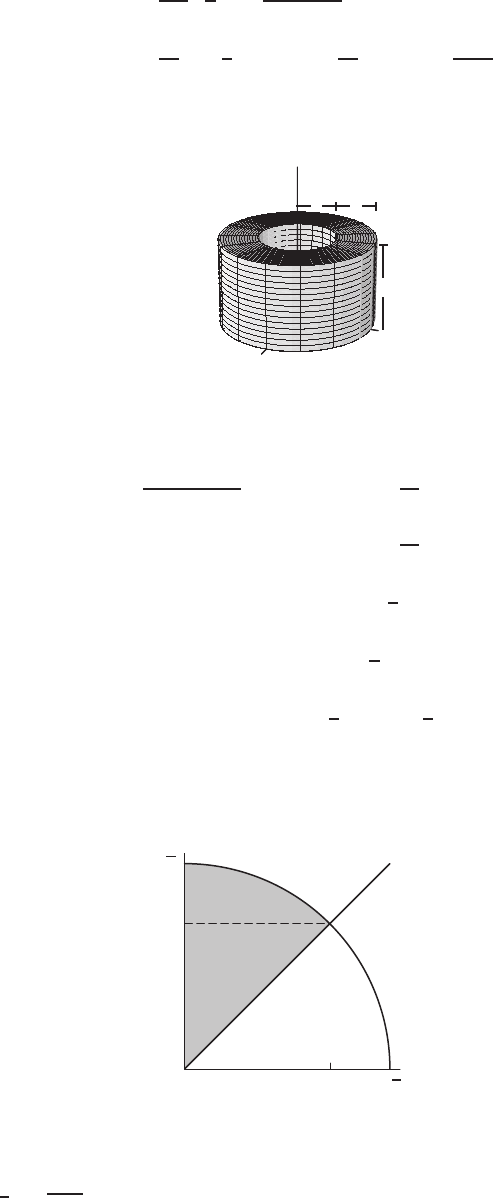
SOLUTIONS to Review Problems for Chapter Sixteen 1569
=243
5·2
3Z2π
0
1 + cos 2θ
2dθ
=81
5(θ+1
2sin 2θ)
2π
0
=81
5(2π+ 0) = 162π
5
62. Wis a cylindrical shell, so cylindrical coordinates should be used. See Figure 16.145.
✻
❄
4
✲✛
1
✲✛
1
x
y
z
Figure 16.145
ZW
z
(x2+y2)3/2dV =Z4
0Z2π
0Z2
1
z
r3rdr dθ dz
=Z4
0Z2π
0Z2
1
z
r2dr dθ dz
=Z4
0Z2π
0
(−z
r)
2
1
dθ dz
=Z4
0Z2π
0
z
2dθ dz
=Z4
0
z
2·2π dz =1
2π·z2
4
0
=8π
63. (a) The region (shaded) is one eighth of the circle x2+y2= 8; see Figure 16.146. The first integral is above the dashed
line y= 2; the second integral is below the dashed line.
2√8
2
√8
y=x
x2+y2= 8
x
y
Figure 16.146
(b) Converting to polar coordinates, we find the quantity in part (a) is given by
Z√8
2Z√8−y2
0
e−x2−y2dx dy +Z2
0Zy
0
e−x2−y2dx dy
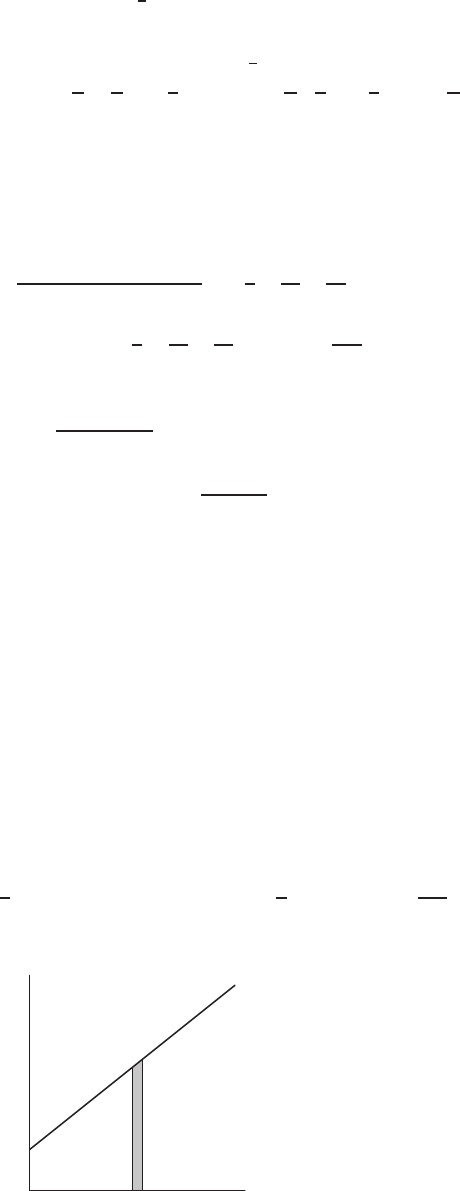
1570 Chapter Sixteen /SOLUTIONS
=Zπ/2
π/4Z√8
0
e−r2r dr dθ
=π
2−π
4−1
2e−r2
√8
0
=π
41
2e0−1
2e−8=π
81−e−8.
64. The depth of the lake is given in meters and the diameter in kilometers. We should work with a single unit of length. In
this solution we work with kilometers, but meters would work just as well.
The shape of the lake suggests integration in polar coordinates, with rkm measured from the center of the island.
Thus t=r−1is the distance in kilometers from the island when rvaries between 1 and 5. The depth of the lake rkm
from the center of the island is
Depth =100(r−1)(4 −(r−1))
1000 =−1
2+3r
5−r2
10 km.
Volume of the lake =Z2π
0Z5
1−1
2+3r
5−r2
10 r dr dθ =32π
5= 20.1km3.
65. (a) The equation of the curved surface of this half cylinder along the x-axis is (y−1)2+z2= 1. The part we want is
z=p1−(y−1)20≤y≤2 0 ≤x≤10.
(b) The integral
ZD
f(x, y, z)dV =Z10
0Z2
0Z√1−(y−1)2
0
f(x, y, z)dz dy dx.
66. Figure 16.147 shows a slice through the region for a fixed x. Breaking the volume into small cubes each of volume
∆V= ∆x∆y∆zand stacking the cubes above (x, y, 0),starting at z= 0 and going up to z=x+y, tells us the inner
integral is Zx+y
0
dz.
Lining up the stacks parallel to the zaxis gives a slice, for each fixed value of x, from y= 0 to x+y= 5, thus the middle
integral is Z5−x
0Zx+y
0
dz dy.
Finally, adding up the contributions for x= 0 to x= 5 gives the volume, V, as
V=Z5
0Z5−x
0Zx+y
0
dz dy dx =Z5
0Z5−x
0
(x+y)dy dx
=Z5
0
(xy +1
2y2)
y=5−x
y=0
dx =Z5
0x(5−x) + 1
2(5 −x)2dx =125
3.
z=x+y
y
z
Figure 16.147
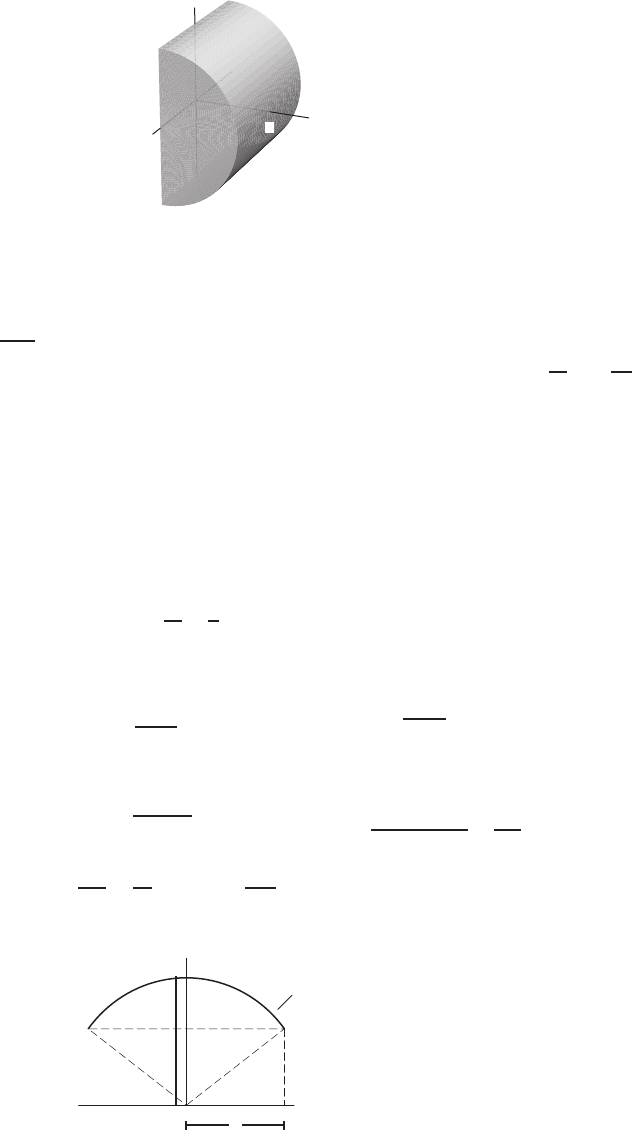
SOLUTIONS to Review Problems for Chapter Sixteen 1571
67. (a) The region is the half cylinder in Figure 16.148.
11
1
x
y
z
Figure 16.148
(b) Use cylindrical coordinates with xreplacing zand yin place of xand zin place of y. Then
Z1
−1Z1
−1Z√1−z2
0
f(x, y, z)dy dz dx =Z1
−1Zπ/2
−π/2Z1
0
r3·r dr dθ dx =x
1
−1
θ
π/2
−π/2
r5
5
1
0
=2π
5.
68. (a) The density increases at a rate of (25 −1)/12 = 2 gm/cm2for each cm of radius. Thus, at radius r,
Density = 1 + 2rgm/cm2.
Thus
Mass =Z2π
0Z12
0
(1 + 2r)r dr dθ gm.
(b) Evaluating gives
Mass =Z2π
0r2
2+2
3r3
12
0
dθ = 2π·1224 = 2448πgm.
69. Orient the region as shown in Figure 16.149 and use cylindrical coordinates with the origin at the center of the sphere.
The equation of the sphere is x2+y2+z2= 25, or r2+z2= 25. If z= 3, then r2+ 32= 25, so r2= 16 and r= 4.
Volume =Z2π
0Z4
0Z√25−r2
3
r dzdrdθ =Z2π
0Z4
0
rz
z=√25−r2
z=3
drdθ
=Z2π
0Z4
0
(rp25 −r2−3r)drdθ =θ
2π
0−(25 −r2)3/2
3−3r2
2
4
0
=2π125
3−27
3−24=52π
3= 54.45 cm3.
5
5
✻
❄
3
✻
❄
2✠
Sphere
r2+z2= 25
✲✛ 4
r
z
Figure 16.149

1572 Chapter Sixteen /SOLUTIONS
70. The region of integration is shown in Figure 16.150, and the mass of the given solid is given by
x
y
z
3
4
12
z= 12 −4x−3y
✛4x+ 3y= 12
or
y=1
3(12 −4x)
Figure 16.150
Mass =ZR
δ dV
=Z3
0Z1
3(12−4x)
0Z12−4x−3y
0
x2dz dy dx
=Z3
0Z1
3(12−4x)
0
x2z
z=12−4x−3y
z=0
dydx
=Z3
0Z1
3(12−4x)
0
x2(12 −4x−3y)dydx
=Z3
0
x2(12y−4xy −3
2y2)
y=1
3(12−4x)
0
dx
=8x3−4x4+8
15 x5
3
0
=108
5.
71. Orient the region as shown in Figure 16.151 and use spherical coordinates with the origin at the center of the sphere. The
equation of the sphere is x2+y2+z2= 25, or ρ= 5. The plane z= 3 is the plane ρcos φ= 3, so ρ= 3/cos φ. In
Figure 16.151, angle AOB is given by
cos φ=3
5,so φ= arccos(3/5).
The volume is given by
V=Z2π
0Zarccos(3/5)
0Z5
3/cos φ
ρ2sin φ dρdφdθ =θ
2π
0Zarccos(3/5)
0
sin φρ3
3
p=5
p=3/cos φ
dφ
= 2πZarccos(3/5)
0125
3−9
cos3φsin φ dφ
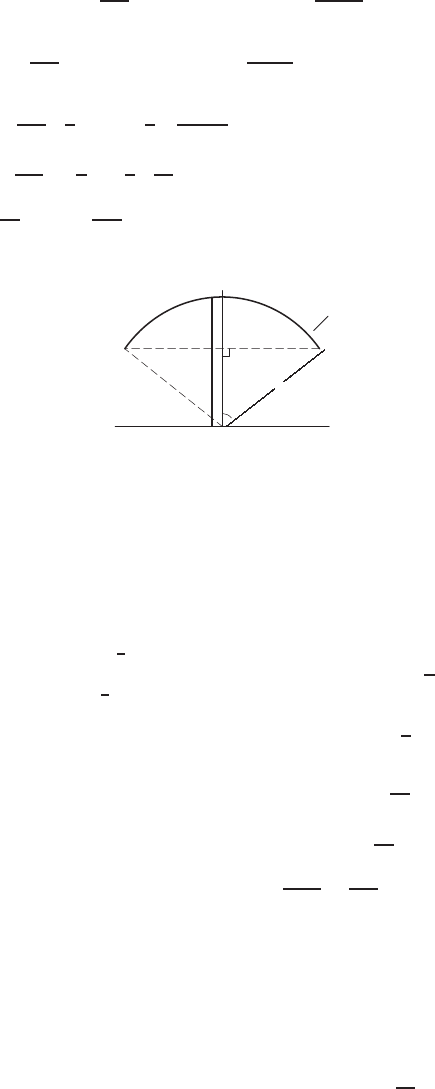
SOLUTIONS to Review Problems for Chapter Sixteen 1573
= 2πZarccos(3/5)
0
125
3sin φ dφ −Zarccos(3/5)
0
9
cos3φsin φ dφ
= 2π −125
3cos φ
arccos(3/5)
0−91
2 cos2φ
arccos(3/5)
0!
= 2π−125
33
5−1−9
21
(3/5)2−1
= 2π−125
3−2
5−9
216
9
= 2π50
3−8=52π
3≈54.45 cm3.
O
φ
✠
Sphere
ρ= 5
B
A
✻
❄
3
✻
❄
2
✛
✛
5
x
z
Figure 16.151
72. Let the lower left part of the forest be at (0,0). Then the other corners have coordinates as shown. The population density
function is then given by
ρ(x, y) = 10 −2y
The equations of the two diagonal lines are x=−2y/5and x= 6 + 2y/5. So the total rabbit population in the forest is
Z5
0Z6+ 2
5y
−2
5y
(10 −2y)dx dy =Z5
0
(10 −2y)(6 + 4
5y)dy
=Z5
0
(60 −4y−8
5y2)dy
= (60y−2y2−8
15 y3)
5
0
= 300 −50 −8
15 ·125
=2750
15 =550
3≈183
73. We use spherical coordinates. Since the density, δ, is equal to the distance from the point to the origin, we have
δ=ρgm/cm3.
Therefore the mass of the hemisphere is given by
Mass =Z2π
0Zπ/2
0Z2
0
ρ·ρ2sin φ dρdφdθ =Z2π
0Zπ/2
0
ρ4
4
2
0
sin φ dφdθ
= 4 Z2π
0Zπ/2
0
sin φ dφdθ = 4 Z2π
0
(−cos φ)
π/2
0
dθ= 4 ·2π·1 = 8πgm.
74. Since the hole resembles a cylinder, we will use cylindrical coordinates. Let the center of the sphere be at the origin, and
let the center of the hole be the z-axis (see Figure 16.152).

1574 Chapter Sixteen /SOLUTIONS
x
y
z
a
✠
R
❘
√a2−R2
Figure 16.152
Then we will integrate from z=−√a2−R2to z=√a2−R2, and each cross-section will be an annulus. So the
volume is
Z√a2−R2
−√a2−R2Z2π
0Z√a2−z2
R
rdr dθ dz =Z√a2−R2
−√a2−R2Z2π
0
1
2(a2−z2−R2)dθ dz
=πZ√a2−R2
−√a2−R2
(a2−z2−R2)dz
=π(a2−R2)(2pa2−R2)−1
3(2(a2−R2)3
2)
=4π
3(a2−R2)3
2
75. We must first decide on coordinates. We pick Cartesian coordinates with the smaller sphere centered at the origin, the
larger one centered at (0,0,−1). A vertical cross-section of the region in the xz-plane is shown in Figure 16.153. The
smaller sphere has equation x2+y2+z2= 1. The larger sphere has equation x2+y2+ (z+ 1)2= 2.
−1
✠x2+y2+z2= 1
✠
x2+y2+ (z+ 1)2= 2
x
z
Figure 16.153
Let Rrepresent the region in the xy-plane which lies directly underneath (or above) the region whose volume we
want. The curve bounding this region is a circle, and we find its equation by solving the system:
x2+y2+z2= 1
x2+y2+ (z+ 1)2= 2
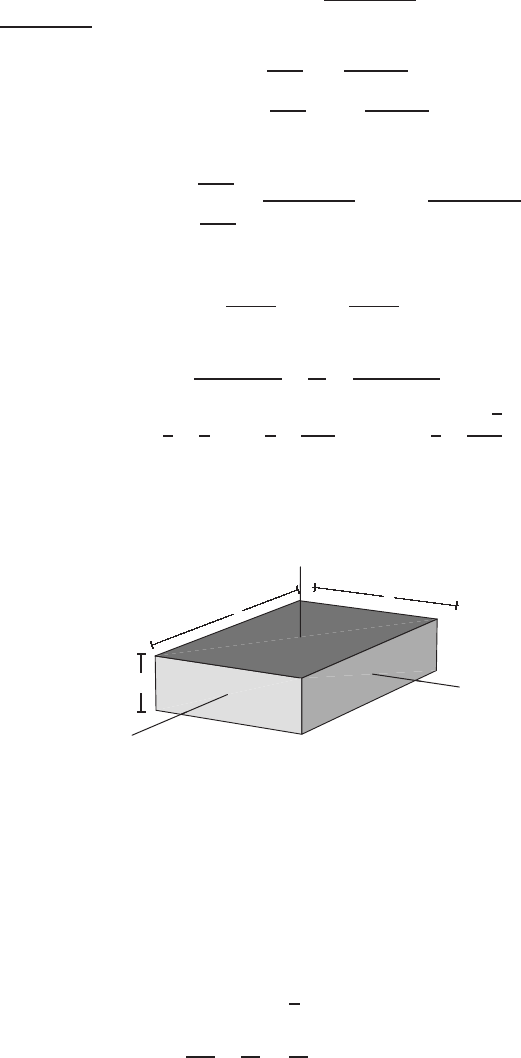
SOLUTIONS to Review Problems for Chapter Sixteen 1575
Subtracting the equations gives
(z+ 1)2−z2= 1
2z+ 1 = 1
z= 0.
Since z= 0, the two surfaces intersect in the xy-plane in the circle x2+y2= 1. Thus Ris x2+y2≤1.
The top half of the small sphere is represented by z=p1−x2−y2; the top half of the large sphere is represented
by z=−1 + p2−x2−y2. Thus the volume is given by
Volume =Z1
−1Z√1−x2
−√1−x2Z√1−x2−y2
−1+√2−x2−y2
dz dy dx.
Starting to evaluate the integral, we get
Volume =Z1
−1Z√1−x2
−√1−x2
(p1−x2−y2+ 1 −p2−x2−y2)dydx.
We simplify the integral by converting to polar coordinates
Volume =Z2π
0Z1
0p1−r2+ 1 −p2−r2r drdθ
=Z2π
0−(1 −r2)3/2
3+r2
2+(2 −r2)3/2
3
1
0
dθ
= 2π1
2+1
3−−1
3+23/2
3= 2π7
6−2√2
3= 1.41.
76. Suppose the brick is set up as shown in Figure 16.154.
x
y
z
✻
❄
1
✛
✛
✛
✛
5
3
Figure 16.154
The brick has m/v =density = 1. The moment of inertia about the z-axis is
Iz=Z5/2
−5/2Z3/2
−3/2Z1/2
−1/2
1(x2+y2)dz dy dx
=Z5/2
−5/2Z3/2
−3/2
(x2+y2)dy dx
=Z5/2
−5/2
(3x2+9
4)dx
=125
4+45
4=85
2

1576 Chapter Sixteen /SOLUTIONS
The moment of inertia about the y-axis is
Iy=Z5/2
−5/2Z3/2
−3/2Z1/2
−1/2
1(x2+z2)dz dy dx
=Z5/2
−5/2Z3/2
−3/2
(x2+1
12 )dy dx
=Z5/2
−5/2
(3x2+1
4)dx
=125
4+5
4=65
2
The moment of inertia about the x-axis is
Ix=Z5/2
−5/2Z3/2
−3/2Z1/2
−1/2
1(y2+z2)dz dy dx
=Z5/2
−5/2Z3/2
−3/2
(y2+1
12 )dy dx
=Z5/2
−5/2
(9
4+1
4)dx
= 5 ·10
4=25
2
77. Let the ball be centered at the origin. Since a ball looks the same from all directions, we can choose the axis of rotation;
in this case, let it be the z-axis. It is best to use spherical coordinates, so then
x2+y2= (ρsin φcos θ)2+ (ρsin φsin θ)2
=ρ2sin2φ
Then m/v =Density = 1, so the moment of inertia is
Iz=ZR
0Z2π
0Zπ
0
1(ρ2sin2φ)ρ2sin φ dφ dθ dρ
=ZR
0Z2π
0Zπ
0
ρ4(sin φ)(1 −cos2φ)dφ dθ dρ
=ZR
0Z2π
0
ρ4(−cos φ+1
3cos3φ)
π
0
dθ dρ
=ZR
0Z2π
0
4
3ρ4dθ dρ
=ZR
0
8π
3ρ4dρ =8
15 πR5
78. Set up the cylinder with the base centered at the origin on the xy plane, facing up. (See Figure 16.155.) Newton’s Law of
Gravitation states that the force exerted between two particles is
F=Gm1m2
ρ2
where Gis the gravitational constant, m1and m2are the masses, and ρis the distance between the particles. We take a
small volume element, so m1=m, and m2=δdV . In cylindrical coordinates, if mis at (0,0,0) and δdV is at (r, θ, z),
(see Figure 16.155), then the distance from mto δdV is given by ρ=√r2+z2for r1≤r≤r2and 0≤z≤h.
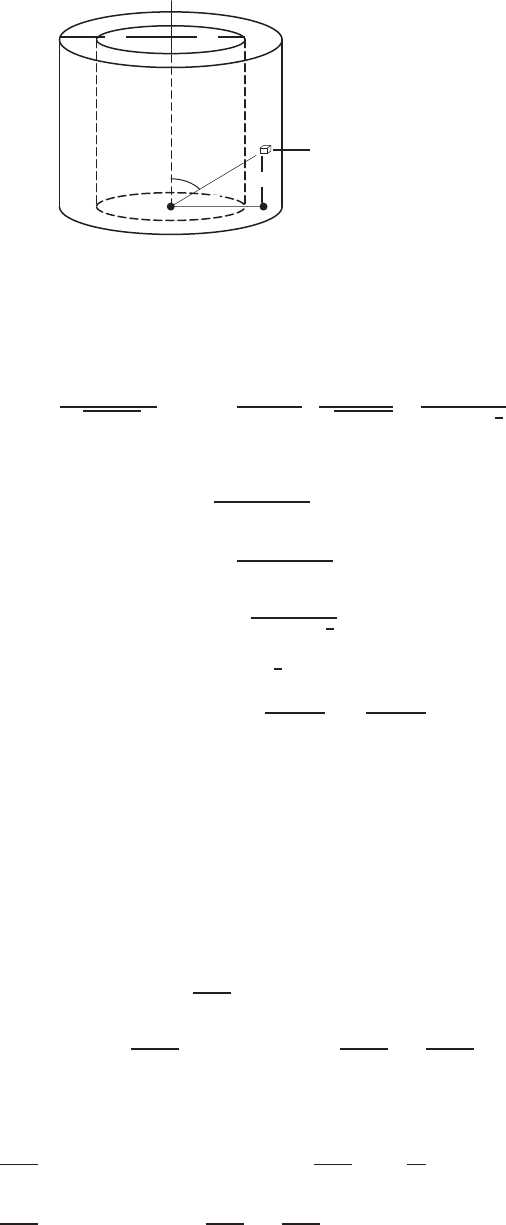
SOLUTIONS to Review Problems for Chapter Sixteen 1577
z
✻
❄
z
r
m
φ
✛δdV
✲✛ r1
✲✛ r2
Figure 16.155
Due to the symmetry of the cylinder the sum of all the horizontal forces is zero; the net force on mis vertical. The force
acting on the particle as a result of the small piece dV makes an angle φwith the vertical and therefore has vertical
component
Vertical force on
particle from small
piece of cylinder
=GmδdV
(√r2+z2)2·cos φ=GmδdV
r2+z2·z
√r2+z2=Gmδz
(r2+z2)3
2
dV.
Thus, since dV =rdzdrdθ,
Total force =Z2π
0Zr2
r1Zh
0
Gmδz
(r2+z2)3/2r dzdrdθ
= 2πGmδ Zr2
r1Zh
0
zr
(r2+z2)3/2drdz
= 2πGmδ Zr2
r11−r
(r2+h2)1
2dr
= 2πGmδ(r−(r2+h2)1
2)
r2
r1
= 2πGmδ(r2−r1−pr2
2+h2+pr2
1+h2).
79. (a) The constant kis determined by the condition that RRk(x+y)dA= 1 where the region Ris the quarter disk with
radius 10
x2+y2≤100 x≥0y≥0.
Using polar coordinates gives the integral
ZR
k(x+y)dA=Zπ/2
0Z10
0
k(rcos θ+rsin θ)r dr dθ
=kZπ/2
0Z10
0
r2(cos θ+ sin θ)dr dθ
=kZπ/2
0
1000
3(cos θ+ sin θ)dθ
=1000k
3(sin θ−cos θ)
π2
0
=1000k
32 = 2000k
3.
Since 2000k/3 = 1, we have k= 3/2000.
(b) Evaluate the integral RSfdA where Sis the region 0≤r≤7,0≤θ≤π/2. We have
ZS
fdA =3
2000 Zπ/2
0Z7
0
r2(cos θ+ sin θ)dr dθ =3
2000 Zπ/2
0
73
3(cos θ+ sin θ)dθ
=73
2000 (sin θ−cos θ)
π/2
0
=73
2000 2 = 343
1000 .
The probability that the point is closer than 7 units from the origin is 343/1000.
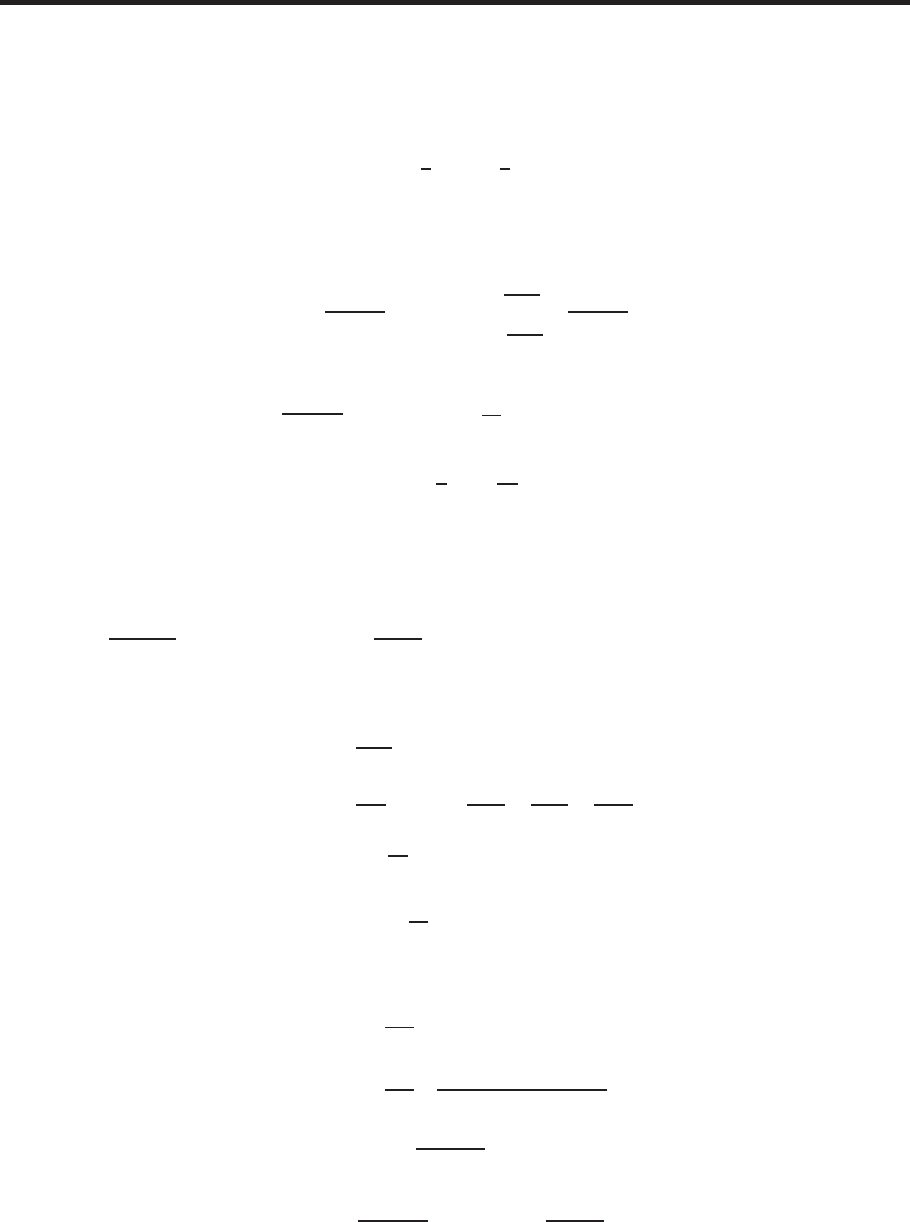
1578 Chapter Sixteen /SOLUTIONS
CAS Challenge Problems
80. The region is the triangle to the right of the y-axis, below the line y= 1, and above the line y=x. Thus the integral can
be written as R1
0R1
xey2dydx or as R1
0Ry
0ey2dxdy. The second of these integrals can be evaluated easily by hand:
Z1
0Zy
0
ey2dxdy =Z1
0ey2x
x=y
x=0 dy =Z1
0
yey2dy
=1
2ey2
1
0
=1
2(e−1)
The other integral cannot be done by hand with the methods you have learned, but some computer algebra systems will
compute it and give the same answer.
81. In Cartesian coordinates the integral is
ZD
3
px2+y2dA =Z1
−1Z√1−x2
−√1−x2
3
px2+y2dydx.
In polar coordinates it is
ZD
3
px2+y2dA =Z2π
0Z1
0
3
√r2rdrdθ =Z2π
0Z1
0
r5/3drdθ
=Z2π
0
3
8dθ =6π
7
The Cartesian coordinate version requires the use of a computer algebra system. Some CASs may be able to handle it
and may give the answer in terms of functions called hypergeometric functions. To compare the answers are the same you
may need to ask the CAS to give a numerical value for the answer. It’s possible your CAS will not be able to handle the
integral at all.
82. Z1
0Z0
−1
x+y
(x−y)3dydx = 1/2and R0
−1R1
0
x+y
(x−y)3dxdy =−1/2. This does not contradict the theorem because the
function is not continuous everywhere inside the region of integration. In fact, it is not even defined at the origin.
83.
Average value for F=1
Area Zh
−hZh
−h
(a+bx4+cy4+dx2y2+ex3y3)dx dy
=1
4h24ah2+4bh6
5+4ch6
5+4dh6
9
=a+1
45 (9b+ 9c+ 5d)h4
The limit is
lim
h→0(a+1
45 (9b+ 9c+ 5d)h4) = a.
Notice that F(0,0) = a.
Average value for G=1
4h2Zh
−hZh
−h
(asin(kx) + bcos(ky) + c)dx dy
=1
4h2 4ch2k+bh sin(hk)
k!
=c+bsin(hk)
hk .
The limit is
lim
h→0c+bsin(hk)
hk =c+blim
h→0
sin(hk)
hk =b+c.
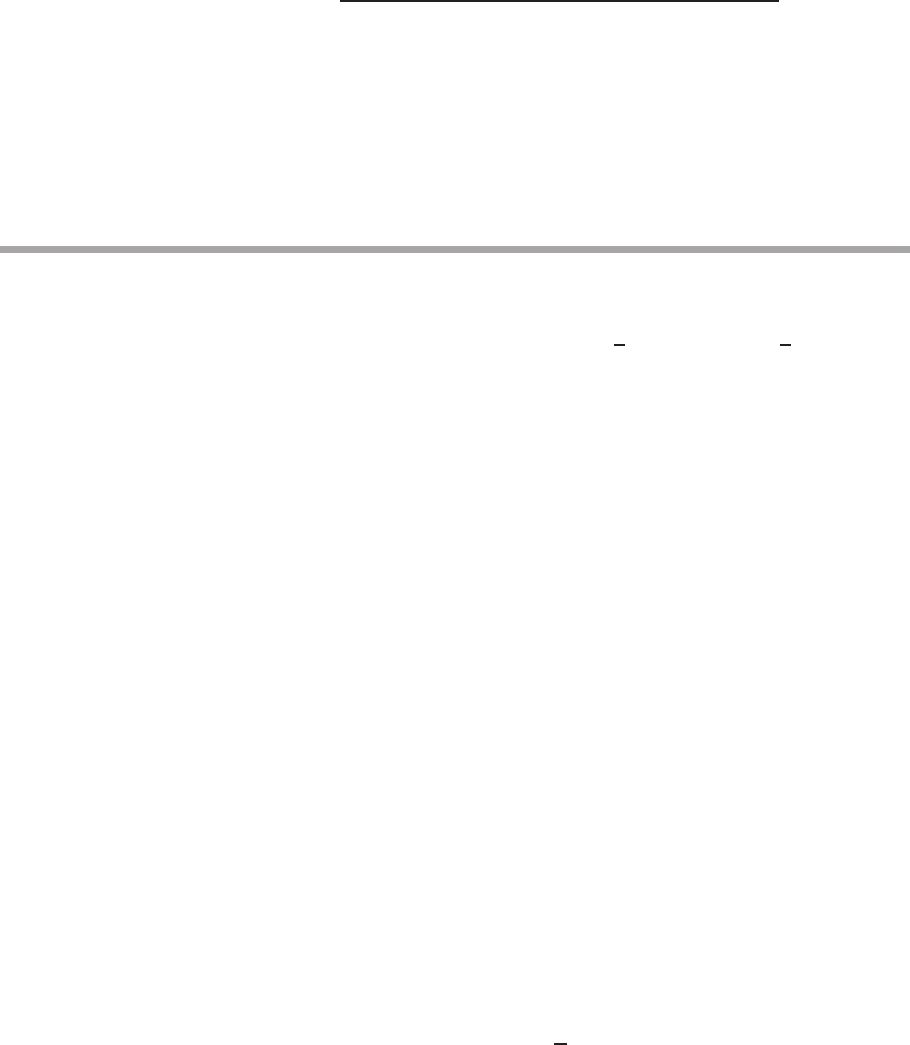
PROJECTS FOR CHAPTER SIXTEEN 1579
Notice that G(0,0) = b+c.
Finally,
Average value for H=(a+b)−1+e2h−2−2h−h2+e2h2−2h+h2
4e2hh2.
You may need to simplify the answer given by your CAS to get this form. The limit of this as h→0(calculated with a
CAS) is 0. This is equal to H(0,0).
In each case the limit of the average values over smaller and smaller squares centered at the origin is equal to the value
of the function at the origin. We conjecture that this is true in general for a continuous function. This makes sense because
when the square is small, the function is approximately constant on the square with value equal to its value at the origin.
Therefore the integral is approximately the area times the value of the function, so the average value is approximately the
value of the function. This approximation gets better and better as h→0.
PROJECTS FOR CHAPTER SIXTEEN
1. (a) We are integrating over the whole plane, so converting to polar coordinates gives
Z∞
−∞ Z∞
−∞
e−(x2+y2)dxdy =Z2π
0Z∞
0
e−r2rdrdθ =Z2π
0−1
2e−r2
∞
0
dθ =Z2π
0
1
2dθ =π.
(b) Rewriting the integrand as a product gives
Z∞
−∞Z∞
−∞
e−(x2+y2)dxdy =Z∞
−∞ Z∞
−∞
e−x2e−y2dxdy.
Now e−y2is a constant as far as the integral with respect to xis concerned, so
Z∞
−∞Z∞
−∞
e−x2e−y2dxdy =Z∞
−∞
e−y2Z∞
−∞
e−x2dxdy.
We assume that the integral with respect to xconverges, and so is a constant as far as the integral with
respect to yis concerned. Thus, we have
Z∞
−∞
e−y2Z∞
−∞
e−x2dxdy =Z∞
−∞
e−x2dxZ∞
−∞
e−y2dy.
But R∞
−∞ e−x2dx and R∞
−∞ e−y2dy are the same number, so we can write
Z∞
−∞Z∞
−∞
e−(x2+y2)dxdy =Z∞
−∞
e−x2dxZ∞
−∞
e−y2dy=Z∞
−∞
e−x2dx2
.
(c) Using the results of parts (a) and (b), we have
Z∞
−∞
e−x2dx2
=Z∞
−∞Z∞
−∞
e−(x2+y2)dxdy =π.
Taking square roots and observing that the integral we are looking for is positive, we have
Z∞
−∞
e−x2dx =√π.
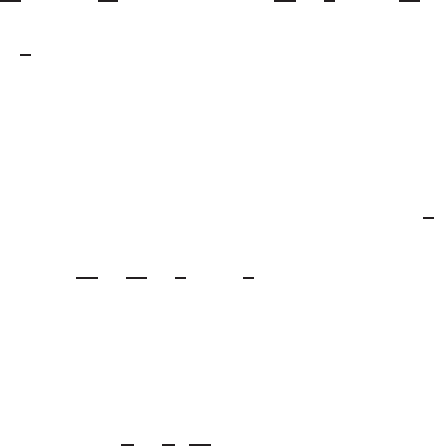
1580 Chapter Sixteen /SOLUTIONS
2. (a) We want to find the average value of |x−y|over the square 0≤x≤1,0≤y≤1:
Average distance between gates =Z1
0Z1
0|x−y|dy dx.
Let’s fix x, with 0≤x≤1. Then |x−y|=y−xfor y≥x
x−yfor y≤x.Therefore
Z1
0|x−y|dy=Zx
0
(x−y)dy +Z1
x
(y−x)dy
=xy −y2
2
x
0
+y2
2−xy
1
x
=x2−x2
2+1
2−x−x2
2+x2
=x2−x+1
2.
So,
Average distance between gates =Z1
0Z1
0|x−y|dy dx
=Z1
0Z1
0|x−y|dydx =Z1
0
(x2−x+1
2)dx
=x3
3−x2
2+1
2x
1
0
=1
3.
(b) There are (n+ 1)2possible pairs (i, j)of gates, i= 0,...,n,j = 0,...,n, so the sum given represents
the average distances apart of all such gates. The Riemann sum with ∆x= ∆y= 1/n, if we choose the
least xand y-values in each subdivision is
n−1
X
i=0
n−1
X
j=0
i
n−j
n
1
n2,
which for large nis just about the same as the other sum. For n= 5 the sum is about 0.389; for n= 10
the sum is about 0.364.

17.1 SOLUTIONS 1581
CHAPTER SEVENTEEN
Solutions for Section 17.1
Exercises
1. Since we are moving on the y-axis, x= 0, and ygoes from −2to 1. Thus a possible parameterization is
x= 0, y =t, −2≤t≤1.
2. We want a quarter-circle of radius 2starting at (2,0) and ending at (0,2). The equations x= 2 cos t,y= 2 sin tdescribe
counterclockwise motion in a circle of radius 2centered at the origin, passing (2,0) when t= 0 and (0,2) when t=π/2.
So a possible parameterization is
x= 2 cos t, y = 2 sin t, 0≤t≤π/2.
3. As we move down the straight line from (0,3) to (1,0),xincreases linearly from 0to 1and ydecreases linearly from 3
to 0. Thus a possible parameterization is
x=t, y = 3 −3t, 0≤t≤1.
4. We want the bottom half of a semicircle of radius 1centered at (0,1). The equations x= cos t, y = 1 + sin tdescribe
clockwise motion in this circle, passing (−1,1) when t=πand (1,1) when t= 2π. So a possible parameterization is
x= cos t, y = 1 + sin t, π ≤t≤2π.
5. We want the straight line segment from (1,1) to (3,2). The position vector of (1,1) is~
i+~
jand the displacement vector
from (1,1) to (3,2) is 2
~
i+~
j, so the line has equation
~r =~
i+~
j+t(2
~
i+~
j),
or
x= 1 + 2t, y = 1 + t.
This passes (1,1) when t= 0 and (3,2) when t= 1, so a possible parameterization is
x= 1 + 2t, y = 1 + t, 0≤t≤1.
6. The curve is a segment of a parabola y=ax2starting at (0,0) and ending up at (2,2). Thus the parabola has equation
y=1
2x2. Since xgoes from 0to 2, a possible parameterization is
x=t, y =1
2t2,0≤t≤2.
7. One possible parameterization is
x=t, y = 1, z =−t.
8. One possible parameterization is
x= 3 + t, y = 2t, z =−4−t.
9. One possible parameterization is
x= 1, y = 0, z =t.
10. One possible parameterization is
x= 5, y =−1 + 5t, z = 1 + 2t.
11. One possible parameterization is
x= 1 + 3t, y = 2 −3t, z = 3 + t.
1582 Chapter Seventeen /SOLUTIONS
12. One possible parameterization is
x=−3 + 2t, y = 4 + 2t, z =−2−3t.
13. The displacement vector from the first point to the second is ~v = (−1−(−3))
~
i+ (−3−(−2))~
j+ (−1−1)~
k=
2
~
i−~
j−2~
k. The line through point (−3,−2,1) and with direction vector ~v = 2
~
i−~
j−2~
kis given by parametric
equations
x=−3 + 2t,
y=−2−t,
z= 1 −2t.
Other parameterizations of the same line are also possible.
14. The displacement vector from the first point to the second is ~v = 4
~
i−5~
j−3~
k. The line through point (1,5,2) and
with direction vector ~v = 4
~
i−5~
j−3~
kis given by parametric equations
x= 1 + 4t,
y= 5 −5t,
z= 2 −3t.
Other parameterizations of the same line are also possible.
15. The vector connecting the two points is 3
~
i−~
j+~
k. So a possible parameterization is
x= 2 + 3t, y = 3 −t, z =−1 + t.
16. The line passes through (3,−2,2) and (0,2,0). The displacement vector from the first of these points to the second is
~v = (0 −3)
~
i+ (2 −(−2))~
j+ (0 −2)~
k=−3
~
i+ 4~
j−2~
k. The line through point (3,−2,2) and with direction
vector ~v =−3
~
i+ 4~
j−2~
kis given by parametric equations
x= 3 −3t,
y=−2 + 4t,
z= 2 −2t.
Other parameterizations of the same line are also possible.
17. The line passes through (3,0,0) and (0,0,−5). The displacement vector from the first of these points to the second is
~v =−3
~
i−5~
k. The line through point (3,0,0) and with direction vector ~v =−3
~
i−5~
kis given by parametric
equations
x= 3 −3t,
y= 0,
z=−5t.
Other parameterizations of the same line are also possible.
18. A vector along the line through these points is ~v = 2
~
i+ 2~
j−~
k. Since the line goes through the point (2,1,3), a
parametric equation for the line segment is
x= 2 + 2t, y = 1 + 2t, z = 3 −twith 0≤t≤1.
19. Since the radius is 3, the center is (0,0,5), and the circle lies in the z= 5 plane, a parametric equation is
x= 3 cos t, y = 3 sin t, z = 5,for 0≤t < 2π.
20. The vector ~n = 2
~
i−3~
j−~
kis normal to the plane, so the line is in the direction of ~n and through the point (1,1,6).
A possible equation is
x= 1 + 2t, y = 1 −3t, z = 6 −t.
21. The xy-plane is where z= 0, and to make the particle go in the clockwise direction we start at (2,0,0) and head in the
negative y-direction. Thus one possible answer is
x= 2 cos t, y =−2 sin t, z = 0.

17.1 SOLUTIONS 1583
22. Since the radius is 2, the circle must be of the form x= 2 cos t, y = 2 sin t, z = 1. But this parameterization traces out the
circle clockwise when viewed from below. Therefore, the parameterization we want is x= 2 cos t, y =−2 sin t, z = 1.
23. The xz-plane is y= 0, so one possible answer is
x= 2 cos t, y = 0, z = 2 sin t.
24. The circle lies in the plane z= 2, so one possible answer is
x= 3 cos t, y = 3 sin t, z = 2.
25. The yz-plane is x= 0, so the circle of radius 3in the yz-plane centered at the origin would have equations
x= 0, y = 3 cos t, z = 3 sin t.
To move the center to (0,0,2) we add 2to the equation for z, so one possible answer is
x= 0, y = 3 cos t, z = 2 + 3 sin t.
26. The circle of radius 5in the yz-plane centered at the origin has equations
x= 0, y = 5 cos t, z = 5 sin t.
To move the center to (−1,0,−2), we add −1to the equation for xand −2to the equation for z, so one possible answer
is
x=−1, y = 5 cos t, z =−2 + 5 sin t.
27. The xy-plane is z= 0, so a possible answer is
x=t2, y =t, z = 0.
28. The xy-plane is z= 0, so a possible answer is
x=t, y =t3, z = 0.
29. The xz-plane is y= 0, so a possible answer is
x=−3t2, y = 0, z =t.
30. The plane z= 2 cuts the cone z=px2+y2in the circle
2 = px2+y2.
This circle is centered on the z-axis, lies in the plane z= 2, and has radius 2. A parametric equation is
x= 2 cos t, y = 2 sin t, z = 2,for 0≤t < 2π.
31. Since the curve is parallel to the xy-plane, zis constant, and since it passes through (0,4,4), we have z= 4. One possible
answer is
x=t, y = 4 −5t4, z = 4.

1584 Chapter Seventeen /SOLUTIONS
32. Since its diameters are parallel to the yand z-axes and its center is in the yz-plane, the ellipse must lie in the yz-plane,
x= 0. The ellipse with the same diameters centered at the origin would have its y-coordinate range between −5/2and
5/2and its z-coordinate range between −1and 1. Thus this ellipse has equation
x= 0, y =5
2cos t, z = sin t.
To move the center to (0,1,−2), we add 1to the equation for yand −2to the equation for z, so one possible answer for
our ellipse is
x= 0, y = 1 + 5
2cos t, z =−2 + sin t.
33. Since its diameters lie along the xand y-axes and its center is the origin, the ellipse must lie in the xy-plane, hence at
z= 0. The x-coordinate ranges between −3and 3and the y-coordinate between −2and 2. One possible answer is
x= 3 cos t, y = 2 sin t, z = 0.
34. Since its diameters are parallel to the xand z-axes, the ellipse must be parallel to the xz-plane. The ellipse with the same
diameters, but centered at the origin, would have its x-coordinate range between −3/2and 3/2and its z-coordinate range
between −1and 1. Thus this ellipse has equation
x=3
2cos t, y = 0, z = sin t.
Since our ellipse has center (0,1,−2), it must be in the plane y= 1. To move the center to (0,1,−2), we add 1 to the
equation for yand −2to the equation for z, so one possible answer for our ellipse is
x=3
2cos t, y = 1, z =−2 + sin t.
35. The displacement vector between the points is ~u = 3
~
i+ 5~
k, so a possible parameterization of the line is
x=−1 + 3t, y = 2, z =−3 + 5t.
36. The vector from P0to P1is ~v = (5 + 1)
~
i+ (2 + 3)~
j= 6
~
i+ 5~
j. Since P0=−~
i−3~
j, the line is
~r (t) = −~
i−3~
j+t(6
~
i+ 5~
j)for 0≤t≤1.
In coordinate form, the equations are x=−1 + 6t,y=−3 + 5t,0≤t≤1
37. The vector from P0to P1is ~v = (4 −1)
~
i+ (1 + 3)~
j+ (−3−2)~
k= 3
~
i+ 4~
j−5~
k. Since P0has position vector
~
i−3~
j+ 2~
k, the line is
~r (t) = ~
i−3~
j+ 2~
k+t(3
~
i+ 4~
j−5~
k)for 0≤t≤1.
In coordinate form the equations are x= 1 + 3t,y=−3 + 4t,z= 2 −5t.
38. Since the semicircle is in the yz-plane we have x= 0. A circle of radius 5in the yz-plane, centered at the origin and
parameterized in the clockwise direction (from the positive z-axis toward the positive y-axis), goes from (0,0,5) to
(0,0,−5). It has equations y= 5 cos tand z=−5 sin t. The semicircle where y≥0is the obtained by restricting tto
−π/2≤t≤π/2. Thus a possible answer is
x= 0, y = 5 cos t, z =−5 sin t, −π/2≤t≤π/2.
39. Since the semicircle is in the xy-plane we have z= 0. A circle of radius 1in the xy-plane, centered at the origin
and parameterized in the counterclockwise direction, goes from (1,0,0) to (−1,0,0). It has equations x= cos tand
y= sin t. The semicircle where y≥0is the obtained by restricting tto 0≤t≤π. Thus a possible answer is
x= cos t, y = sin t, z = 0,0≤t≤π.

17.1 SOLUTIONS 1585
40. The graph is parameterized by x=t,y=√t. To obtain the segment, we restrict tto 1≤t≤16. Thus one possible
answer is
x=t, y =√t, 1≤t≤16.
41. The line segment P Q has length 10, so it must be a diameter of the circle. The center of the circle is therefore the midpoint
of P Q, which is the point (5,0). The upper arc of the circle between Pand Qcan be parameterized as follows:
~r (t) = 5
~
i+ 5(−cos t
~
i+ sin t~
j),0≤t≤π.
The lower arc can be parameterized as follows:
~r (t) = 5
~
i+ 5(cos t
~
i+ sin t~
j), π ≤t≤2π.
42. The equation for zis z= 3. The x-coordinate goes from 4 to 0 and the y-coordinate from 0 to −3, so possible equations
for xand yare x= 4 cos tand y=−3 sin t, with tfrom 0to π/2. Thus one possible answer is
x= 4 cos t, y =−3 sin t, z = 3 0 ≤t≤π/2.
Problems
43. We find the parameterization in terms of the displacement vector −−→
OP = 2
~
i+ 5~
jfrom the origin to the point Pand the
displacement vector −−→
P Q = 10
~
i+ 4~
jfrom Pto Q.
~r (t) = −−→
OP +t−−→
P Q or, expressed in coordinates, ~r (t) = (2 + 10t)
~
i+ (5 + 4t)~
j. To see that this is correct, note
that the equation parameterizes a line because it is linear, that t= 0 corresponds to −−→
OP + 0−−→
P Q =−−→
OP , the vector from
the origin to P, and that t= 1 corresponds to −−→
OP + 1−−→
P Q =−−→
OQ, the vector from the origin to Q.
44. We find the parameterization in terms of the displacement vector −−→
OP = 2
~
i+ 5~
jfrom the origin to the point Pand the
displacement vector −−→
P Q = 10
~
i+ 4~
jfrom Pto Q.
~r (t) = −−→
OP + (t/5)−−→
P Q or ~r (t) = (2 + (t/5)10)
~
i+ (5 + (t/5)4)~
j
45. We find the parameterization in terms of the displacement vector −−→
OP = 2
~
i+ 5~
jfrom the origin to the point Pand the
displacement vector −−→
P Q = 10
~
i+ 4~
jfrom Pto Q.
~r (t) = −−→
OP +t−20
10 −−→
PQ=2 + t−20
10 10~
i+5 + t−20
10 4~
j.
46. We find the parameterization in terms of the displacement vector −−→
OP = 2
~
i+ 5~
jfrom the origin to the point Pand the
displacement vector −−→
P Q = 10
~
i+ 4~
jfrom Pto Q.
~r (t) = −−→
OP + (t−10)−−→
P Q or ~r (t) = (2 + (t−10)10)
~
i+ (5 + (t−10)4)~
j
47. We find the parameterization in terms of the displacement vector −−→
OP = 2
~
i+ 5~
jfrom the origin to the point Pand the
displacement vector −−→
P Q = 10
~
i+ 4~
jfrom Pto Q.
~r (t) = −−→
OP −t−−→
P Q or ~r (t) = (2 −10t)
~
i+ (5 −4t)~
j
48. Substituting t=−1into the parametric equations tells us that the plane passes through the point
(x, y, z) = (8,−12,−6).
A vector parallel to the line is ~v =−3
~
i+ 5~
j+ 6~
k . This vector is normal to the plane, so an equation for the plane is
−3(x−8) + 5(y+ 12) + 6(z+ 6) = 0,or
−3x+ 5y+ 6z=−120.
49. The line is in the direction of the vector ~v = 7
~
i+ 3~
j−2~
kand the vector ~n = 2
~
i−3~
j+ 5~
kis normal to the given
plane. If the vectors ~v and ~n are perpendicular then the line and the plane are parallel. Since
~v ·~n = (7)(2) + (3)(−3) + (−2)(5) = −5,
the line and the plane are not parallel.

1586 Chapter Seventeen /SOLUTIONS
50. These equations parameterize a line. Since (3 + t) + (2t) + 3(1 −t) = 6, we have x+y+ 3z= 6. Similarly,
x−y−z= (3 + t)−2t−(1 −t) = 2. That is, the curve lies entirely in the plane x+y+ 3z= 6 and in the plane
x−y−z= 2. Since the normals to the two planes, ~n1=~
i+~
j+ 3~
kand ~n2=~
i−~
j−~
kare not parallel, the line is
the intersection of two nonparallel planes, which is a straight line in 3-dimensional space.
51. (a) A vector on the line will lie in both planes and will therefore be orthogonal to both normal vectors. To produce a
vector orthogonal to two given vectors, you can take their cross product.
(b) The vector (
~
i+ 2~
j−3~
k)×(3
~
i−~
j+~
k) = −~
i−10~
j−7~
kis parallel to the line.
(c) We need a point on the line and a vector parallel to the line. We found a vector in part (b). To find a point, we
set z= 0 and solve for xand yin the equations for the planes. We have x+ 2y= 7 and 3x−y= 0 from
which x= 1 and y= 3. Hence, the point (1,3,0) is on the line. Finally, a parametric equation for the line is
~r = (1 −t)
~
i+ (3 −10t)~
j−7t~
k. Other answers are possible.
52. The vector 2
~
i−~
j+~
kis in the direction of the line and therefore parallel to the plane. The line (and thus the plane)
contains the point (1,3,4). The displacement vector between (1,3,4) and (2,3,4) is the vector~
i, and this vector is also
parallel to the plane. A normal, ~n , to the plane is the cross product
~n = (2
~
i−~
j+~
k)×~
i=
~
i~
j~
k
2−11
1 0 0
=~
j+~
k .
The equation of the plane has the form y+z=d. Substituting either of the points gives
y+z= 7.
53. (a) The line is parallel to a normal vector, ~n , to the plane
~n = 2
~
i−3~
j−~
k .
Since the line goes through the point (1,3,7), its equation is
~r = (
~
i+ 3~
j+ 7~
k) + t(2
~
i−3~
j−~
k).
(b) Rewriting the equation of the line as
x= 1 + 2t, y = 3 −3t, y = 7 −t,
we substitute into the equation of the plane 2x−3y=zto get
2(1 + 2t)−3(3 −3t) = 7 −t
4t+ 9t+t= 7 −2 + 9
t= 1.
Thus, the point of intersection is x= 3,y= 0,z= 6.
(c) The distance between (1,3,7) and the plane is measured along the line perpendicular to the plane. Thus, it is the
distance from (1,3,7) to (3,0,6):
Distance =p(1 −3)2+ (3 −0)2+ (7 −6)2=√14.
54. (a) The line segment starting at P0and ending at P1is parametrized by
~r (t) = −−→
OP0+t−−−→
P0P1,0≤t≤1.
We write this in coordinates: Let P0= (x0, y0, z0)and P1= (x1, y1, z1). Then a vector between the points is
−−−→
P0P1= (x1−x0)
~
i+ (y1−y0)~
j+ (z1−z0)~
k, so
~r (t) = (x0
~
i+y0~
j+z0~
k) + t((x1−x0)
~
i+ (y1−y0)~
j+ (z1−z0)~
k),
or
x(t) = x0+t(x1−x0) = (1 −t)x0+tx1
y(t) = y0+t(y1−y0) = (1 −t)y0+ty1
z(t) = z0+t(z1−z0) = (1 −t)z0+tz1
17.1 SOLUTIONS 1587
Thus we have
~r (t) = (1 −t)−−→
OP0+t−−→
OP1.
(b) The parametric equation ~r (t) = t−−→
OP0+ (1 −t)−−→
OP1,0≤t≤1is the line segment from P1to P0, the same line
segment as in part (a), but traversed in the opposite direction.
55. (a) Normal vectors to the two planes are
~n1= 2
~
i−~
j−3~
kand ~n2=~
i+~
j+~
k .
The vector ~n1×~n2is perpendicular to both planes and parallel to the line of intersection:
~n1×~n2=
~
i~
j~
k
2−1−3
11 1
= 2
~
i−5~
j+ 3~
k .
(b) To check that the point (1,−1,1) lies on the planes, substitute into each equation.
2x−y−3z= 2 ·1−(−1) −3·1 = 0
x+y+z= 1 −1 + 1 = 1.
Thus, the point lies on both planes.
(c) Parametric equations of the line are
x= 1 + 2t, y =−1−5t, z = 1 + 3t.
56. Since the point of intersection is on the plane 2x−3y+ 5z=−7and on the line
x= 5 + 7t, y = 4 + 3t, z =−3−2t
for some t, substituting the equations of the line into the plane equation gives
2(5 + 7t)−3(4 + 3t) + 5(−3−2t) = −7.
Solving for tgives t=−2and so the point of intersection is x= 5 + 7(−2) = −9, y = 4 + 3(−2) = −2,
z=−3−2(−2) = 1.
57. The coefficients of tin the parameterizations show that line ~r 1is parallel to the vector −3
~
i+ 2~
j+~
kand line ~r 2is
parallel to −6
~
i+ 4~
j+ 3~
k. Since these vectors are not parallel, the lines are not parallel, so the lines are different.
58. The coefficients of tin the parameterizations show that line ~r 1is parallel to the vector −3
~
i+~
j+ 2~
kand line ~r 2is
parallel to 6
~
i−2~
j−4~
k. Since these vectors are parallel, the lines are parallel. To see if they are the same line, check
whether they have a common point. If so, every point is common. Pick any point on ~r 1, say where t= 0, which shows that
the point (5,1,0) is on line ~r 1. To determine whether this point is on line ~r 2, search for a solution of the simultaneous
equations
2 + 6t= 5 2 −2t= 1 2 −4t= 0.
The solution of the first equation is t= 1/2, which also solves the other two equations, which shows that the point
(5,1,0) is on line ~r 2, corresponding to t= 1/2.
Since the two lines are parallel and go through a common point, they are the same line.
59. The coefficients of tin the parameterizations show that line ~r 1is parallel to the vector −3
~
i+~
j+ 2~
kand line ~r 2is
parallel to 6
~
i−2~
j−4~
k. Since these vectors are parallel, the lines are parallel. To see if they are the same line, check
whether they have a common point. If so, every point is common., Pick any point on ~r 1, say where t= 0, which shows
that the point (5,1,0) is on line ~r 1. To determine whether this point is on line ~r 2, search for a solution of the simultaneous
equations
2 + 6t= 5 2 −2t= 1 3 −4t= 0.
The solution of the first equation is t= 1/2, which is not a solution of the third equation, so there is no common solution.
The two lines are parallel but they are different, because one line contains the point (5,1,0) and the other does not.
60. The lines intersect if
c+t=s
1 + t= 1 −s
5 + t= 3 + s.
Solving the last two equations gives t=−1and s= 1. Substituting into the first equation gives c= 2.

1588 Chapter Seventeen /SOLUTIONS
61. (a) The line can be written as
x= 2 + 3t, y = 5 + t, z = 2t.
We substitute into x+y+z= 1 and solve
(2 + 3t) + (5 + t) + 2t= 1
6t+ 7 = 1
t=−1.
Thus, the point is (x, y, z) = (2 + 3(−1),5−1,2(−1)) = (−1,4,−2).
(b) The vector ~v = 3
~
i+~
j+ 2~
kis parallel to the line; the normal vector ~n =~
i+~
j+~
kis perpendicular to the plane.
Thus
~v ×~n =
~
i~
j~
k
31 2
1 1 1
=−~
i−~
j+ 2~
k
is perpendicular to the line and lies in the plane. Other answers are possible.
(c) The line passes through (−1,4,−2) and is parallel to −~
i−~
j+ 2~
k. Its equation can be written
~r =−~
i+ 4~
j−2~
k+t(−~
i−~
j+ 2~
k).
62. Add the two equations to get 3x= 8, or x=8
3. Then we have
−y+z=1
3.
So a possible parameterization is
x=8
3, y =t, z =1
3+t.
63. Add the two equations to get 2x+3z= 5, or x=−3
2z+5
2. Subtract the two equations to get 2y−z= 1, or y=1
2z+1
2.
So a possible parameterization is
x=−3
2t+5
2, y =1
2t+1
2, z =t.
64. Let f(x, y, z) = x2+y2−z. Then the surface z=x2+y2is a level surface of fat the value 0. The gradient of fis
perpendicular to the level surface.
grad f= 2x
~
i+ 2y~
j−~
k= 2
~
i+ 4~
j−~
k .
So a possible parameterization is
x= 1 + 2t, y = 2 + 4t, z = 5 −t.
65. Parametric equations for a line in 3-space are in the form
x=x0+at
y=y0+bt
z=z0+ct
where (x0, y0, z0)is a point on the line and the direction vector is ~v =a
~
i+b~
j+c~
k. We are given the point as (−4,2,3).
The vector ~
j+~
kis parallel to the yz-plane and at an angle of 45◦to both positive y- and z-axes. Thus, the direction
vector for this line is ~v =~
j+~
k. Parametric equations for this line are
x=−4,
y= 2 + t,
z= 3 + t.

17.1 SOLUTIONS 1589
66. The question is equivalent to asking if the line through (−3,−4,2) and (4,5,0) enters the sphere x2+y2+z2= 1. A
parameterization for this line is given by
x=−3 + 7t, y =−4 + 9t, z = 2 −2t.
We want to see whether the line intersects the sphere x2+y2+z2= 1. Substituting we have
(−3 + 7t)2+ (−4 + 9t)2+ (2 −2t)2= 1
29 −122t+ 134t2= 0
Since (122)2−4(29)134 <0, this equation has no real solutions. Thus, the line does not enter the sphere and the point
is visible.
67. (a) Both paths are straight lines, the first passes through the point (−1,4,−1) in the direction of the vector~
i−~
j+ 2~
k
and the second passes through (−7,−6,−1) in the direction of the vector 2
~
i+ 2~
j+~
k. The two paths are not
parallel.
(b) Is there a time twhen the two particles are at the same place at the same time? If so, then their coordinates will be
the same, so equating coordinates we get
−1 + t=−7 + 2t
4−t=−6 + 2t
−1 + 2t=−1 + t.
Since the first equation is solved by t= 6, the second by t= 10/3, and the third by t= 0, no value of tsolves all
three equations. The two particles never arrive at the same place at the same time, and so they do not collide.
(c) Are there any times t1and t2such that the position of the first particle at time t1is the same as the position of the
second particle at time t2? If so then
−1 + t1=−7 + 2t2
4−t1=−6 + 2t2
−1 + 2t1=−1 + t2.
We solve the first two equations and get t1= 2 and t2= 4. This is a solution for the third equation as well, so the
three equations are satisfied by t1= 2 and t2= 4. At time t= 2 the first particle is at the point (1,2,3), and at time
t= 4 the second is at the same point. The paths cross at the point (1,2,3), and the first particle gets there first.
68. (a) The particle moves clockwise around a circle with center (a, a)and radius b, starting at (a, a +b). The motion has
period 2π/k.
(b) (i) Increasing bincreases the radius.
(ii) Increasing amoves the center away from the origin along the line y=x.
(iii) Increasing kmakes the particle move faster and reduces the period.
(iv) If a=b, the circle touches both the x- and y-axes at the points (a, 0) and (0, a), respectively.
69. (a) The curve is a loop because temperature and salinity go through the same changes every year.
(b) At t= 8, mid-August.
(c) At t= 4, mid-April.
(d) From the graph, we have (approximately) T(5) = 15.9,T(6) = 17.8, and T(7) = 20.4. Using a difference quotient,
we have
dT
dt t=6 ≈T(7) −T(5)
2= 2.25 ◦C/month.
The seawater temperature in mid-June is increasing at a rate of about 2◦C per month.
70. (a) The particle is moving in the direction of the vector ~v = (−2−0)
~
i+ (2 −1)~
j+ (−2−0)~
k=−2
~
i+~
j−2~
k .
Since at the point (0,1,0)
grad c(0,1,0)
=−2x
~
i−2y~
j−2z~
ke−(x2+y2+z2)(0,1,0)
=−2e−1~
j ,
the directional derivative, which gives the rate of change we want, is given by
c~v = (−2e−1~
j)·−2
~
i+~
j−2~
k
p(−2)2+ 12+ (−2)2=−2
3e−1microgr/m3per meter.
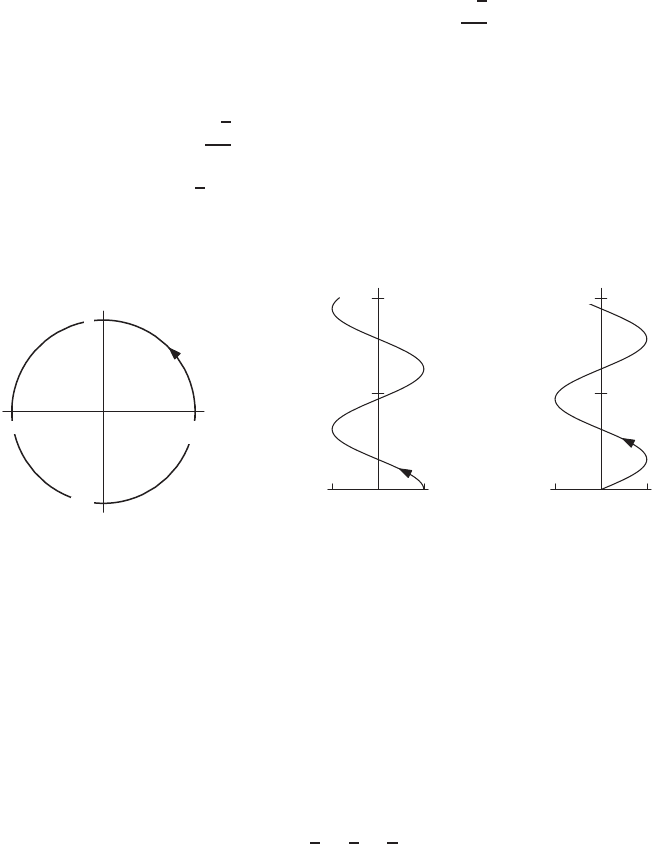
1590 Chapter Seventeen /SOLUTIONS
(b) Substituting the parametric equation of the curve into the concentration, we have the concentration as a function of t:
c(t) = e−(1−t2)2+t2+(1−t2)2=e−(2(1−t2)2+t2).
Differentiating gives
c′(t) = −41−t2(−2t)+ 2te−(2(1−t2)2+t2).
Setting c′(t) = 0 and observing that e−(2(1−t2)2+t2)6= 0,we have
−41−t2(−2t)+ 2t= 0
t−41−t2+ 1= 0
t4t2−3= 0
t= 0,±√3
2.
Since c(t)→0as t→ ∞,one of the critical points gives the global maximum. Substituting gives
c(0) = e−2= 0.135
c±√3
2=e−(2(1−3/4)2+3/4)=e−7/8= 0.417.
Thus, the maxima occur at t=±√3/2seconds.
71. The three shadows appear as a circle, a cosine wave and a sine wave, respectively.
−11
−1
1
x
y
x= cos t
y= sin t
−1 0 1
5
10
x
z
x= cos t
z=t
−1 0 1
5
10
y
z
y= sin t
z=t
Figure 17.1
72. (a) Equations II represent the line y=x.
(b) Equations IV represent the line x+y=a. Since a > 0, this line is not through the origin.
(c) Equations V give the hyperbola x2−y2=a2.
(d) Equations I represent the circle x2+y2=a2, traversed clockwise starting at (0, a).
(e) Equations III represent the circle x2+y2=a2, traversed counterclockwise starting at (a, 0).
73. (a) Parametric equations are
x= 2 + at, y = 1 + bt, z = 3 + ct.
(b) The line goes through the origin if the position vector 2
~
i+~
j+ 3~
kis parallel to the vector a
~
i+b~
j+c~
k. This
occurs if a, b, c are in the ratio 2 : 1 : 3; that is if
a
2=b
1=c
3.
74. (a) The vector −2
~
i+ 7~
j+ 4~
kis parallel to the line. A normal to the plane is a
~
i+b~
j+c~
k. We want the normal to
the plane to be parallel to the line, so we take a=−2, b = 7, c = 4. Any value of dwill do, for example d= 0.
(b) The same values of a, b, c as in part (a) work, though now we need to choose dso that the point (5,3,0) lies on the
plane. So a=−2, b = 7, c = 4 and
d=−2(5) + 7(3) + 4(0) = 11.

17.1 SOLUTIONS 1591
(c) The normal a
~
i+b~
j+c~
kmust be perpendicular to the vector −2
~
i+ 7~
j+ 4~
k, so
−2a+ 7b+ 4c= 0
We can choose any values of a, b, c which satisfy this equation, so a= 7, b = 2, c = 0 work. To ensure that the point
(5,3,0), which lies on the line, also lies on the plane, substitute the coordinates of the point into the plane, giving
d= 7x+ 2y+ 0z= 7(5) + 2(3) = 41.
75. The helices wind around a cylinder of radius α, which explains the significance of α. As tincreases from 0to 2π, the
helix winds once around the cylinder, climbing upward a distance of 2πβ. Thus βcontrols how stretched out the helix is
in the vertical direction. See Figure 17.2 and Figure 17.3.
xy
z
xy
z
xy
z
Figure 17.2
: Three values of αwith the same β
xy
z
xy
z
xy
z
Figure 17.3
: Three values of βwith the same α
76. The displacement from the point (1,2,3) to the point (3,5,7) is 3
~
i+ 5~
j+ 7~
k−(
~
i+ 2~
j+ 3~
k) = 2
~
i+ 3~
j+ 4~
k. So
the equation of the line is
x
~
i+y~
j+z~
k= 1
~
i+ 2~
j+ 3~
k+t(2
~
i+ 3~
j+ 4~
k)
or
x
~
i+y~
j+z~
k= (1 + 2t)
~
i+ (2 + 3t)~
j+ (3 + 4t)~
k .
The square of the distance from a point (x, y, z)on the line to the origin, denoted by D(t)is
D(t) = (x−0)2+ (y−0)2+ (z−0)2
= (1 + 2t)2+ (2 + 3t)2+ (3 + 4t)2
= 1 + 4t+ 4t2+ 4 + 12t+ 9t2+ 9 + 24t+ 16t2
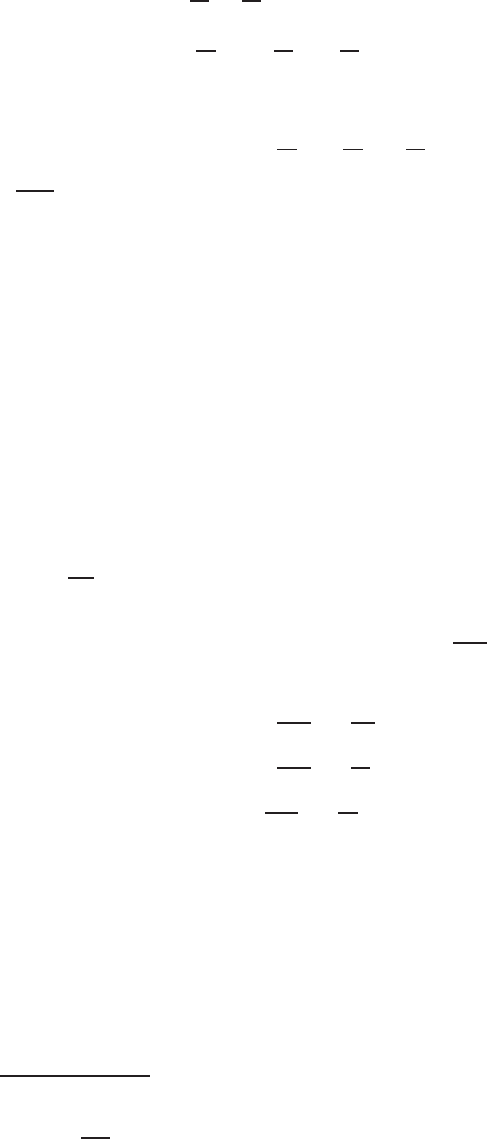
1592 Chapter Seventeen /SOLUTIONS
= 14 + 40t+ 29t2
= 29 t2+40
29 t+14
29
= 29 t+20
29 2
−20
29 2
+14
29 .
Since D(t)is minimum when t=−20/29 and
D(−20/29) = 29 −20
29 2
+14
29 =6
29 ,
the shortest distance is p6/29.
77. The line ~r =~a +t~
bis parallel to the vector ~
band through the point with position vector ~a .
(a) is (vii). The equation ~
b·~r = 0 is a plane perpendicular to ~
band satisfied by (0,0,0).
(b) is (ii). For any constant k, the equation ~
b·~r =kis a plane perpendicular to ~
b. If k=||~a || 6= 0, the plane does not
contain the origin.
(c) is (iv). The equation (~a ×~
b)·(~r −~a ) = 0 is the equation of a plane which is satisfied by ~r =~a , so the point with
position vector ~a lies on the plane. Since ~a ×~
bis perpendicular to ~
b, the plane is parallel to the line, and therefore
it contains the line.
78. (a) Parametric equations are
x= 1 + 2t, y = 5 + 3t, z = 2 −t.
(b) We want to minimize D, the square of the distance of a point to the origin, where
D= (x−0)2+ (y−0)2+ (z−0)2= (1 + 2t)2+ (5 + 3t)2+ (2 −t)2.
Differentiating to find the critical points gives
dD
dt = 2(1 + 2t)2 + 2(5 + 3t)3 + 2(2 −t)(−1) = 0
2 + 4t+ 15 + 9t−2 + t= 0
t=−15
14 .
Thus
x= 1 + 2 −15
14 =−8
7
y= 5 + 3 −15
14 =25
14
z= 2 −−15
14 =43
14 .
Since the distance of the point on the line from the origin increases without bound as the magnitude of x, y, z increase,
the only critical point of Dmust be a global minimum. Therefore, the point (−8/7,25/14,43/14) is the point on
the line closest to the origin.
79. Since the origin is beneath Denver and 1650 meters = 1.65 km, Denver’s coordinates, in kilometers, are (0,0,1.65). From
Figure 17.4, we see the xand ycoordinates of Bismark are given by
x= 850 cos 60◦= 425 km and y= 850 sin 60◦= 736 km.
Since 550 meters = 0.55 km, the coordinates of Bismark in kilometers are (425, 736, 0.55).
The velocity vector, ~v , of the plane is parallel to the vector −−→
DB joining Denver to Bismark, where −−→
DB = 425
~
i+
736~
j+ (0.55 −1.65)~
k= 425
~
i+ 736~
j−1.1~
k.
Since ||−−→
DB|| =√4252+ 7362+ 1.12≈850 km and the plane is moving at 650 km/hr, the velocity vector is given
by
~v =650
850 (425
~
i+ 736~
j−1.1~
k) = 325
~
i+ 563~
j−0.84~
k .
Since the plane is 8000 m= 8 km above Denver, it passes through the point (0,0,9.65). Therefore the parametric
equation is
~r = 9.65~
k+t(325
~
i+ 563~
j−0.84~
k).

17.1 SOLUTIONS 1593
60◦
850
km
Bismark
Denver
x
x
y
y
Figure 17.4
80. (a) We look along the line that passes through P= (1,−2,−1) and is parallel to ~v =~
i+ 2~
j+~
k. The question is
which plane, the blue or the yellow, this line first meets.
Parametric equations for the line are
x= 1 + t, y =−2 + 2t, z =−1 + t.
We substitute these into the equations of the respective planes and solve for tin each case:
(1 + t) + 3(−2 + 2t)−2(−1 + t) = 6 2(1 + t) + (−2 + 2t) + (−1 + t) = 3
5t−3 = 6 5t−1 = 3
t=9
5t=4
5
From this we see that the line first intersects the yellow plane 2x+y+z= 3, when t= 4/5. So you see the yellow
plane. (Note that we did not need to find the points of intersection of the line with the planes.)
(b) A vector from Pto a point on the green line gives a direction looking directly at the line. If we get a parametric
equation for the green line then we can write down a vector from Pto any variable point on the line.
To get a parametric equation we need a vector parallel to the green line and a point that lies on the green line.
We take the cross product of the normal of the blue plane, ~nb=~
i+ 3~
j−2~
k, and the normal of the yellow plane,
~ny= 2
~
i+~
j+~
k. This gives a vector 5
~
i−5~
j−5~
k, so we take ~u =~
i−~
j−~
kas a vector parallel to the green
line.
We also need one point on the line. For that, we can choose a value of z, and find the corresponding values of x
and yon both the blue and yellow planes. Taking z= 0, say, gives the equations x+ 3y= 6 and 2x+y= 3, which
have x= 3/5and y= 9/5as solutions. So a point on the green line is Q= (3/5,9/5,0). Therefore a parametric
equation for the green line is
x=3
5+t, y =9
5−t, z =−t.
A vector from P= (1,−2,−1) to a variable point on the line is then, for −∞ <t<∞,
~v =1−3
5+t~
i+−2−9
5−t~
j+ (−1−(−t))~
k=−2
5+t~
i+−19
5+t~
j+ (−1 + t)~
k .
Thus, if we look in the direction of ~v , for any value of t, we look at the line.
(c) Consider the plane that contains the point Pand the green line; let’s call it the green plane. The green plane divides
3-space into two half-spaces. From P, if we look in a direction pointing into one of the half-spaces we see the yellow
plane (as in part (a)) and if we look in a direction pointing into the other half-space we see the blue plane. We have
to figure out which half-space is which.
We need a normal vector to the green plane. We know the point P= (1,−2,−1) on the plane and the equation
of the green line. We find that a normal vector to the green plane is ~n = 2
~
i+~
j+~
k.
From part (a) we know that the vector ~v =~
i+ 2~
j+~
kpoints from Pinto the half-space where we see the
yellow plane. The dot product of ~n and ~v is
~n ·~v = 2 ·1 + 1 ·2 + 1 ·1 = 5 >0.
This means that any vector pointing into this half-space has a positive dot product with ~n . Thus the condition on a
general vector ~w =a
~
i+b~
j+c~
kto point into this half-space is
2a+b+c > 0;
Similarly, ~w points into the half-space where we see the blue plane if
2a+b+c < 0.
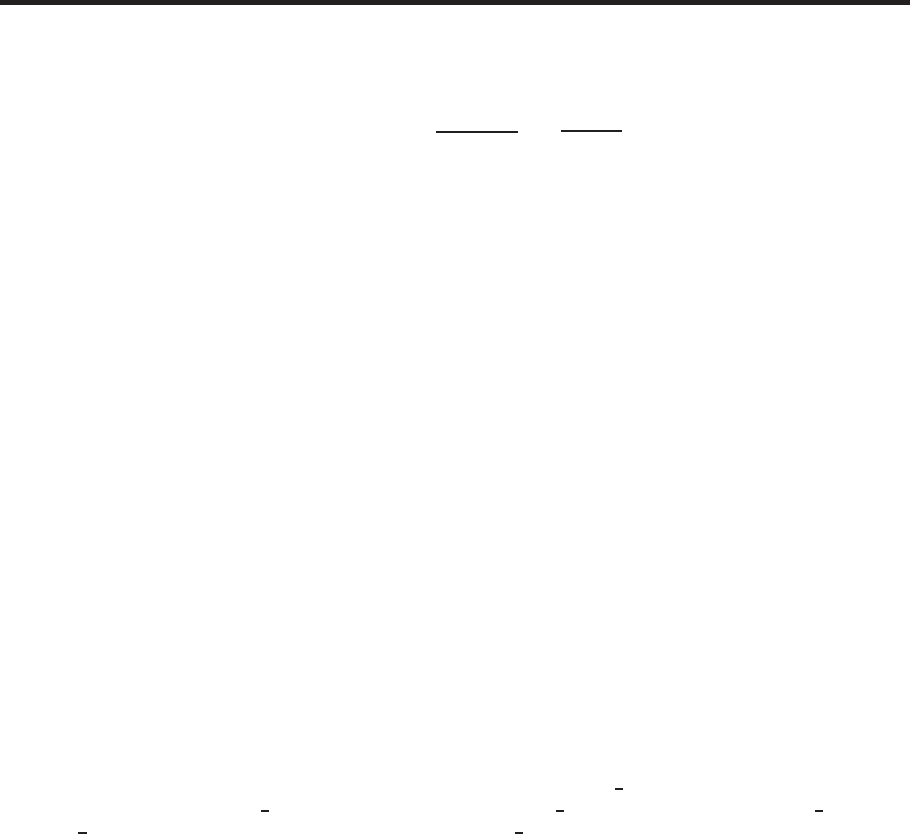
1594 Chapter Seventeen /SOLUTIONS
81. (a) If ~n ·~v = 0, then ~n and ~v are perpendicular. Since P1is perpendicular to ~n and Lis parallel to ~v , we see that P1
and Lare parallel. In fact, Lmay lie in the plane.
(b) Since ~n ×~v is perpendicular to ~n and to ~v , the vector ~n ×~v is parallel to P1and perpendicular to L. Thus, P2,
which is perpendicular to ~n ×~v , is
(i) Perpendicular to P1.
(ii) Parallel to L.
82. (a) (i) is the original graph reflected in both the x- and y-axes, so (C).
(ii) is the original graph reflected in the y-axis, so (A).
(iii) is the original graph shifted right by 1, so (D).
(iv) is the original graph shifted right by 1 and up by 1, so (G).
(b) (i) Not possible; all points would lie on a circle
(ii) Not possible; spiral would be equally spaced.
(iii) Possible; spirals increase in diameter as tincreases.
(iv) Not possible; spiral would be equally spaced.
(v) Not possible; all points would lie on a circle
Strengthen Your Understanding
83. The two parameterizations are different, but the curves they describe are the same. A shift of the curve in space by two
units in the~
i-direction can be parameterized by ~r 2(t) = ~r (t) + 2
~
i.
84. The curve is a helix centered on the z-axis. All its points are at distance |R|from the z-axis. The distance from the origin
to the point on the curve with position vector ~r (t)is given by
Distance =p~r (t)·~r (t) = pR2+t2.
85. The curves x= cos t,y= sin t,z= 0 and x= 0,y= cos t,z= sin tare both unit circles centered at the origin. The
first is in the xy-plane, and the second is in the yz-plane.
86. Examples of two different lines through the point (1,2,3) are given by
~r (t) = ~
i+ 2~
j+ 3~
k+t~
i+2~
j
and
~r (t) = ~
i+ 2~
j+ 3~
k+t~
i−~
k.
87. The line
x=t, y = 2t, z = 3 + 4t
can also be parameterized by
x=t3, y = 2t3, z = 3 + 4t3,
and the functions x=t3,y= 2t3, and z= 3 + 4t3are not linear functions of t.
88. False. The ycoordinate is zero when t= 0, but when t= 0 we have x= 2 so the curve never passes through (0,0).
89. True. Every point (x, y)on this curve satisfies y= (t2)2=x2.
90. False. For example, the graph of x= cos t, y = sin tfor 0≤t≤2πis a circle. A circle is not the graph of a function,
since for some values of xthere are two values of y.
91. True. Every y-coordinate is one less than every x-coordinate, so the equation of the line is y=x−1.
92. False. When t= 0,we have (x, y) = (0,−1).When t=π/2,we have (x, y) = (−1,0).Thus the circle is being traced
out clockwise.
93. True. The functions etand ln tare inverses, so ln et=t. Thus if x=et, y =t, we have y=t= ln et= ln x.
94. True. Taking two values for t, say t= 0 and t= 1 give the points (1,0) and (0,2), which lie on a line with equation
y=−2x+2.The second parameterization describes the same set of points, since y=−4s+2 = −2(2s)+2 = −2x+2.
95. True. Adding the equations z=x+yand z= 1 −x−ygives 2z= 1 or z=1
2.Thus the line of intersection is parallel
to the xy-plane at height z=1
2.Letting xbe the parameter tand z=1
2in the first plane’s equation gives 1
2=t+yor
y=1
2−t. The same result is obtained by setting x=tand z=1
2in the second plane’s equation.
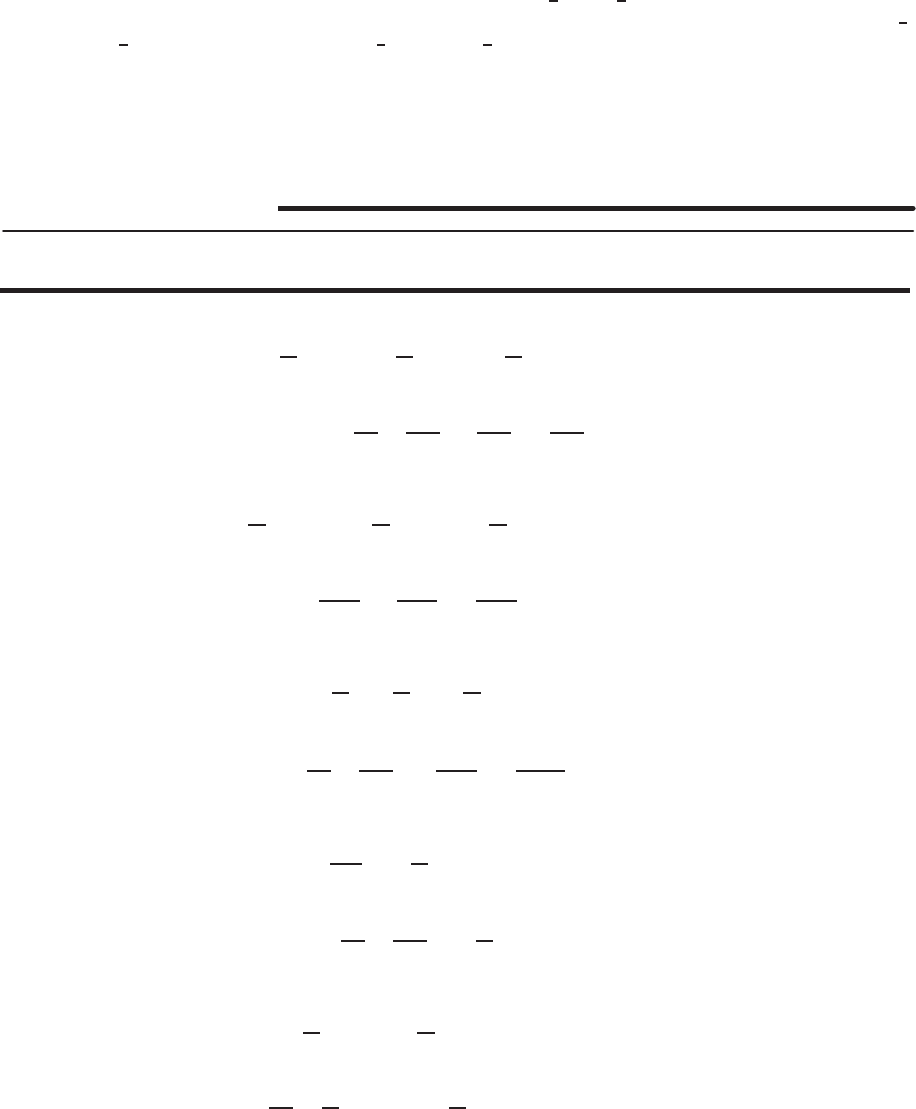
17.2 SOLUTIONS 1595
96. True. To find an intersection point, we look for values of sand tthat make the coordinates in the first line the same as the
coordinates in the second. Setting x=tand x= 2sequal, we see that t= 2s. Setting y= 2 + tequal to y= 1 −s, we
see that t=−1−s. Solving both t= 2sand t=−1−syields t=−2
3, s =−1
3.These values of sand twill give equal
xand ycoordinates on both lines. We need to check if the zcoordinates are equal also. In the first line, setting t=−2
3
gives z=7
3.In the second line, setting s=−1
3gives z=−1
3.As these are not the same, the lines do not intersect.
97. False. All points on this line lie in the plane x= 1, so the line is parallel to the yz-plane.
98. True. The ~
jcomponent of ~r is always one more than twice the~
icomponent, so the line is y= 2x+ 1.
99. False. The line ~r 1(t)is in the direction of the vector~
i−2~
j, while the line ~r 2(t)is in the direction of the vector ~
2i−~
j.
Since these vectors are not parallel (they are not scalar multiples of one another) the lines are not parallel.
Solutions for Section 17.2
Exercises
1. The velocity vector ~v is given by:
~v =d
dt (2 + 3t)
~
i+d
dt (4 + t)~
j+d
dt (1 −t)~
k= 3
~
i+~
j−~
k .
The acceleration vector ~a is given by:
~a =d~v
dt =d(3)
dt ~
i+d(1)
dt ~
j−d(1)
dt ~
k=~
0
2. The velocity vector ~v is given by:
~v =d
dt (2 + 3t2)
~
i+d
dt (4 + t2)~
j+d
dt (1 −t2)~
k= 6t
~
i+ 2t~
j−2t~
k .
The acceleration vector ~a is given by:
~a =d(6t)
dt ~
i+d(2t)
dt ~
j−d(2t)
dt ~
k= 6
~
i+ 2~
j−2~
k .
3. The velocity vector ~v is given by:
~v =d
dt t
~
i+d
dt t2~
j+d
dt t3~
k=~
i+ 2t~
j+ 3t2~
k .
The acceleration vector ~a is given by:
~a =d~v
dt =d(1)
dt t
~
i+d(2t)
dt ~
j+d(3t2)
d~
k= 2~
j+ 6t~
k .
4. The velocity vector ~v is given by:
~v =d(t)
dt ~
i+d
dt (t3−t)~
j=~
i+ (3t2−1)~
j .
The acceleration vector ~a is given by:
~a =d~v
dt =d(1)
dt ~
i+d
dt (3t2−1)~
j= 6t~
j .
5. The velocity vector ~v is given by:
~v =d
dt (3 cos t)
~
i+d
dt (4 sin t)~
j=−3 sin t
~
i+ 4 cos t~
j .
The acceleration vector ~a is given by:
~a =d~v
dt =d
dt (−3 sin t)
~
i+d
dt (4 cos t)~
j=−3 cos t
~
i−4 sin t~
j .
6. Since ~r (t) = 3 cos(t2)
~
i+ 3 sin(t2)~
j+t2~
k , we have
~v (t) = −6tsin (t2)
~
i+ 6tcos (t2)~
j+ 2t~
k ,
~a (t) = (−6 sin (t2)−12t2cos (t2))
~
i+ (6 cos (t2)−12t2sin (t2))~
j+ 2~
k .
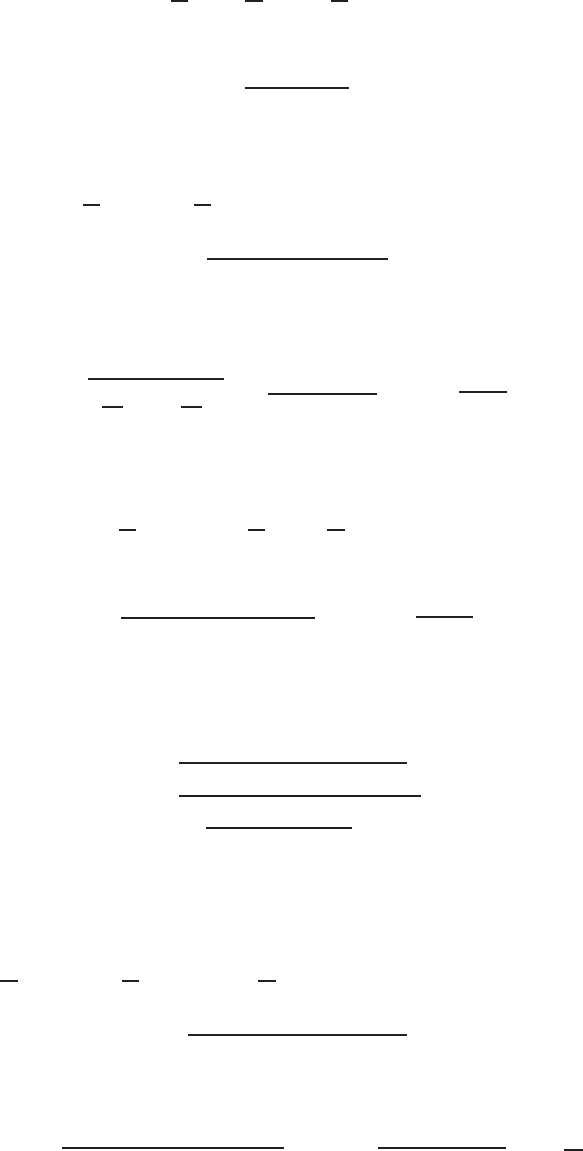
1596 Chapter Seventeen /SOLUTIONS
7. The velocity vector ~v is given by:
~v =d
dt (t)
~
i+d
dt (t2)~
j+d
dt (t3)~
k
=~
i+ 2t~
j+ 3t2~
k .
The speed is given by:
k~v k=p1 + 4t2+ 9t4.
Now k~v kis never zero since 1 + 4t2+ 9t4≥1for all t. Thus, the particle never stops.
8. The velocity vector ~v is given by:
~v =d
dt (cos 3t)
~
i+d
dt (sin 5t)~
j=−3 sin 3t
~
i+ 5 cos 5t~
j .
The speed is given by
k~v k=p9 sin2(3t) + 25 cos2(5t).
Thus, k~v k= 0 when sin(3t) = cos(5t) = 0 but there are no values of tfor which this is true, so the particle never stops.
9. To find ~v (t)we first find dx/dt = 6tand dy/dt = 3t2. Therefore, the velocity vector is ~v = 6t
~
i+ 3t2~
j. The speed of
the particle is given by the magnitude of the vector,
k~v k=rdx
dt 2
+dy
dt 2
=p(6t)2+ (3t2)2= 3|t| · p4 + t2.
The particle stops when ~v =~
0, so when 6t= 3t2= 0. Therefore, the particle stops when t= 0.
10. The velocity vector ~v is given by:
~v =d
dt ((t−1)2)
~
i+d
dt (2)~
j+d
dt (2t3−3t2)~
k
= 2(t−1)
~
i+ (6t2−6t)~
k .
The speed is given by:
k~v k=p(2(t−1))2+ (6t2−6t)2= 2|t−1|p1 + 9t2.
The particle stops when ~v =~
0, so when 2(t−1) = (6t2−6t) = 0. Since these are all satisfied only by t= 1, this is
the only time that the particle stops.
11. To find ~v (t)we first find dx/dt = 6tcos(t2)and dy/dt =−6tsin(t2). Therefore, the velocity is ~v = 6tcos(t2)
~
i−
6tsin(t2)~
j. The speed of the particle is given by
k~v k=p(6tcos(t2))2+ (−6tsin(t2))2
=p36t2(cos(t2))2+ 36t2(sin(t2))2
= 6|t|pcos2(t2) + sin2(t2)
= 6|t|.
The particle comes to a complete stop when speed is 0, that is, if 6|t|= 0, and so when t= 0 .
12. The velocity vector ~v is given by:
~v =d
dt (3 sin2t)
~
i+d
dt (cos t−1)~
j+d
dt (t2)~
k= 6 sin tcos t
~
i−sin t~
j+ 2t~
k .
The speed is given by:
k~v k=p36 sin2tcos2t+ sin2t+ 4t2.
The particle comes to a stop when ~v =~
0, so when when 6 sin tcos t=−sin t= 2t= 0, and so the particle stops when
t= 0.
13. We have
Length =Z2
1p(x′(t))2+ (y′(t))2+ (z′(t))2dt =Z2
1p52+ 42+ (−1)2dt =√42.
This is the length of a straight line from the point (8,5,2) to (13,9,1).
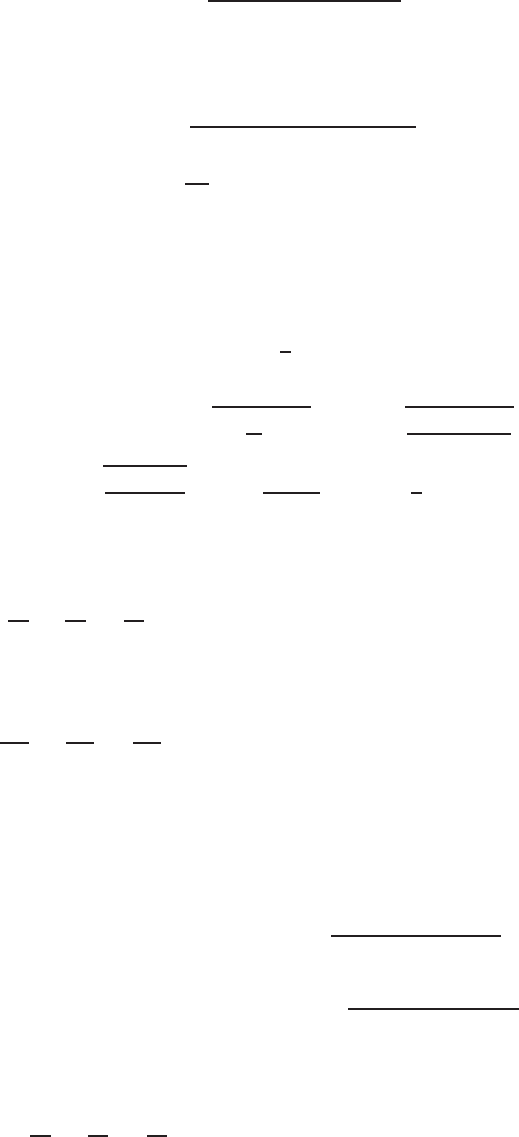
17.2 SOLUTIONS 1597
14. We have
Length =Z2π
0p(−3 sin 3t)2+ (5 cos 5t)2dt.
We cannot find this integral symbolically, but numerical methods show Length ≈24.6.
15. We have
Length =Z1
0p(−etsin(et))2+ (etcos(et))2dt
=Z1
0
√e2tdt =Z1
0
etdt
=e−1.
This is the length of the arc of a unit circle from the point (cos 1,sin 1) to (cos e, sin e)—in other words between the
angles θ= 1 and θ=e. The length of this arc is (e−1).
16. The velocity vector is
~v =~r ′(t) = 2
~
i+1
t~
j+ 2t~
k ,
so
Length of curve =Z2
1||~v ||dt =Z2
1r4 + 1
t2+ 4t2dt =Z2
1r4t2+ 1 + 4t4
t2dt
=Z2
1r(1 + 2t2)2
t2dt =Z2
1
1 + 2t2
tdt =Z2
11
t+ 2tdt = 3 + ln 2.
Note that when we took the square root, we used the fact that (1 + 2t2)/t is positive for 1≤t≤2.
17. The velocity vector ~v is
~v =dx
dt~
i+dy
dt ~
j+dz
dt ~
k= 3(2π)(−sin(2πt))
~
i+ 3(2π) cos(2πt)~
j+ 0~
k
=−6πsin(2πt)
~
i+ 6πcos(2πt)~
j .
The acceleration vector ~a is
~a =d2x
dt2~
i+d2y
dt2~
j+d2z
dt2~
k=−6π(2π) cos(2πt)
~
i+ 6π(2π)(−sin(2πt))~
j
=−12π2cos(2πt)
~
i−12π2sin(2πt)~
j .
To check that ~v and ~a are perpendicular, we check that the dot product is zero:
~v ·~a = (−6πsin(2πt)
~
i+ 6πcos(2πt)~
j)·(−12π2cos(2πt)
~
i−12π2sin(2πt)~
j)
= 72π3sin(2πt) cos(2πt)−72π3cos(2πt) sin(2πt) = 0
The speed is
k~v k=k − 6πsin(2πt)
~
i+ 6πcos(2πt)~
jk= 6πpsin2(2πt) + cos2(2πt) = 6π,
and so is constant. The magnitude of the acceleration is
k~a k=k − 12π2cos(2πt)
~
i−12π2sin(2πt)~
jk= 12π2pcos2(2πt) + sin2(2πt) = 12π2,
which is also constant.
18. The velocity vector ~v is
~v =dx
dt~
i+dy
dt ~
j+dz
dt ~
k= 0
~
i+ 2(3) cos(3t)~
j+ 2(3)(−sin(3t))~
k
= 6 cos(3t)~
j−6 sin(3t)~
k .
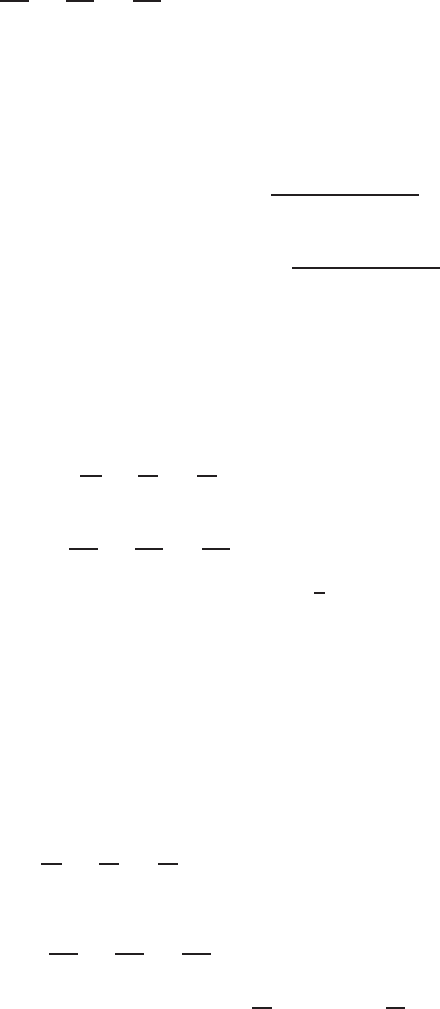
1598 Chapter Seventeen /SOLUTIONS
The acceleration vector ~a is
~a =d2x
dt2~
i+d2y
dt2~
j+d2z
dt2~
k= 6(3)(−sin(3t))~
j−6(3) cos(3t)~
k
=−18 sin(3t)~
j−18 cos(3t)~
k .
To check that ~v and ~a are perpendicular, we check that the dot product is zero:
~v ·~a = (6 cos(3t)~
j−6 sin(3t)~
k)·(−18 sin(3t)~
j−18 cos(3t)~
k)
=−108 cos(3t) sin(3t) + 108 sin(3t) cos(3t) = 0.
The speed is
k~v k=k6 cos(3t)~
j−6 sin(3t)~
kk= 6psin2(3t) + cos2(3t) = 6,
and so is constant. The magnitude of the acceleration is
k~a k=k − 18 sin(3t)~
j−18 cos(3t)~
kk= 18psin2(3t) + cos2(3t) = 18,
which is also constant.
19. In vector form the parameterization is
~r = 2
~
i+ 3~
j+ 5~
k+t2(
~
i−2~
j−~
k).
Thus the motion is along the straight line through (2,3,5) in the direction of~
i−2~
j−~
k. The velocity vector ~v is
~v =dx
dt~
i+dy
dt ~
j+dz
dt ~
k= 2t(
~
i−2~
j−~
k)
The acceleration vector ~a is
~a =d2x
dt2~
i+d2y
dt2~
j+d2z
dt2~
k= 2(
~
i−2~
j−~
k).
The speed is
k~v k= 2|t|k~
i−2~
j−~
kk= 2√6|t|.
The acceleration vector is constant and points in the direction of ~
i−2~
j−~
k. When t < 0the absolute value |t|is
decreasing, hence the speed is decreasing. Also, when t < 0the velocity vector 2t(
~
i−2~
j−~
k)points in the direction
opposite to~
i−2~
j−~
k. When t > 0the absolute value |t|is increasing and hence the speed is increasing. Also, when
t > 0the velocity vector points in the same direction as~
i−2~
j−~
k.
20. In vector form the parameterization is
~r =~
i+−5~
j−2~
k+ (2t3+ 3t)(−~
i+ 2~
j+ 3~
k).
Thus the motion is along the straight line through (1,−5,−2) in the direction of −~
i+ 2~
j+ 3~
k. The velocity vector ~v is
~v =dx
dt~
i+dy
dt ~
j+dz
dt ~
k= (6t2+ 3)(−~
i+ 2~
j+ 3~
k)
The acceleration vector ~a is
~a =d2x
dt2~
i+d2y
dt2~
j+d2z
dt2~
k= 12t(−~
i+ 2~
j+ 3~
k).
The speed is
k~v k=|6t2+ 3|k −~
i+ 2~
j+ 3~
kk= 3√14|2t2+ 1|= 3√14(2t2+ 1).
The graph of the speed is a parabola opening upward with vertex at t= 0. Thus the speed is decreasing when t < 0
and increasing when t > 0. The velocity vector always points in the same direction −~
i+ 2~
j+ 3~
k, since 6t2+ 3 is
always positive. The acceleration vector points in the opposite direction to −~
i+ 2~
j+ 3~
kwhen t < 0and in the same
direction when t > 0. Thus the acceleration vector points in the opposite direction to the speed when t < 0and in the
same direction when t > 0.
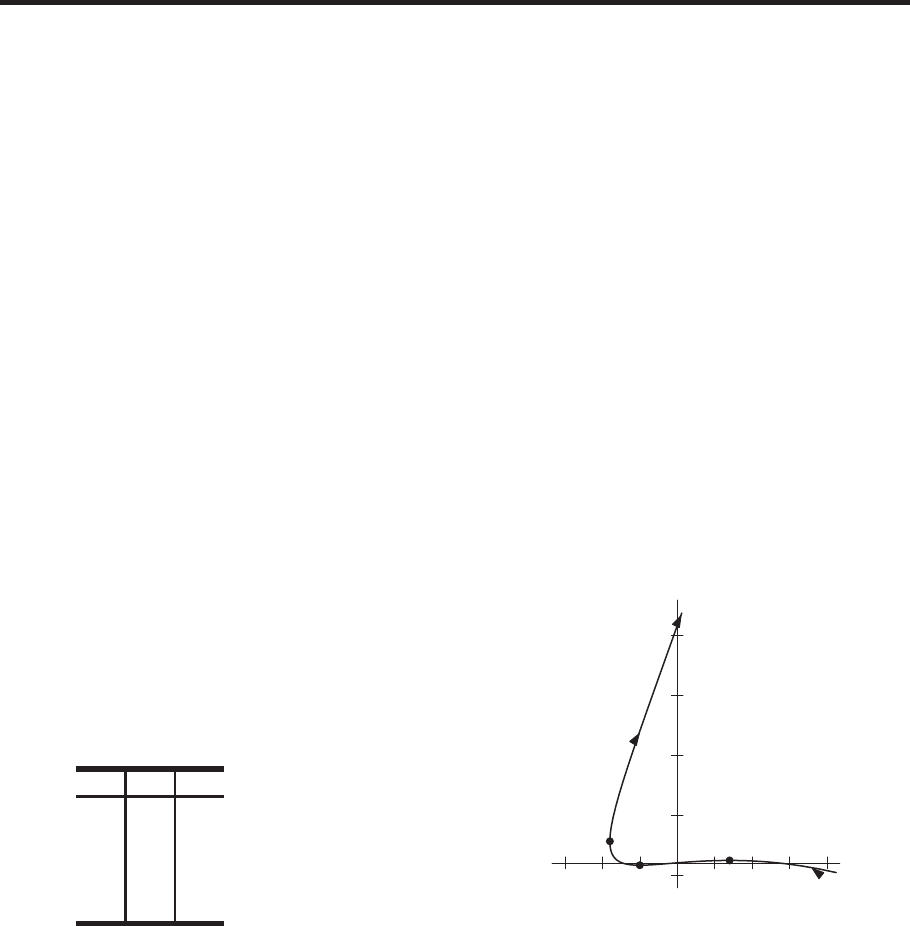
17.2 SOLUTIONS 1599
21. At t= 2, the position and velocity vectors are
~r (2) = (2 −1)2
~
i+ 2~
j+ (2 ·23−3·22)~
k=~
i+ 2~
j+ 4~
k ,
~v (2) = 2 ·(2 −1)
~
i+ (6 ·22−6·2)~
k= 2
~
i+ 12~
k .
So we want the line going through the point (1,2,4) at the time t= 2, in the direction 2
~
i+ 12~
k:
x= 1 + 2(t−2), y = 2 z= 4 + 12(t−2).
Problems
22. A parameterization is
~r (t) = 5
~
i+ 4~
j−2~
k+ (t−4)(2
~
i−3~
j+~
k)
or equivalently
x= 5 + 2(t−4), y = 4 −3(t−4), z =−2 + (t−4).
23. The velocity vector for this motion is
~v = (2t−6)
~
i+ (3t2−3)~
j .
The motion is vertical when the component in the~
idirection is 0 and motion in ~
jdirection is not 0. Motion in~
idirection
is 0 when
2t−6 = 0,
t= 3.
At that time, motion in ~
jdirection is not 0. The motion is horizontal when the component in the ~
jdirection is 0 and
motion in~
idirection is not 0. Motion in ~
jdirection is 0 when
3t2−3 = 0,
t= 1,−1.
At these times, motion in~
idirection is not 0. To determine the end behavior, recall that a polynomial is approximated by
its highest powered term for large values (positive or negative) of the independent variable. Thus, as t→ ±∞, we have
x≈t2and y≈t3. The end behavior, and the xand ycoordinates when the motion is vertical or horizontal, are shown in
Table 17.1. The graph is shown in Figure 17.5.
Table 17.1
t x y
−∞ +∞ −∞
−1 7 2
1−5−2
3−9 18
+∞+∞+∞
−10 10 20
−10
40
90
140
190
x
y
Figure 17.5
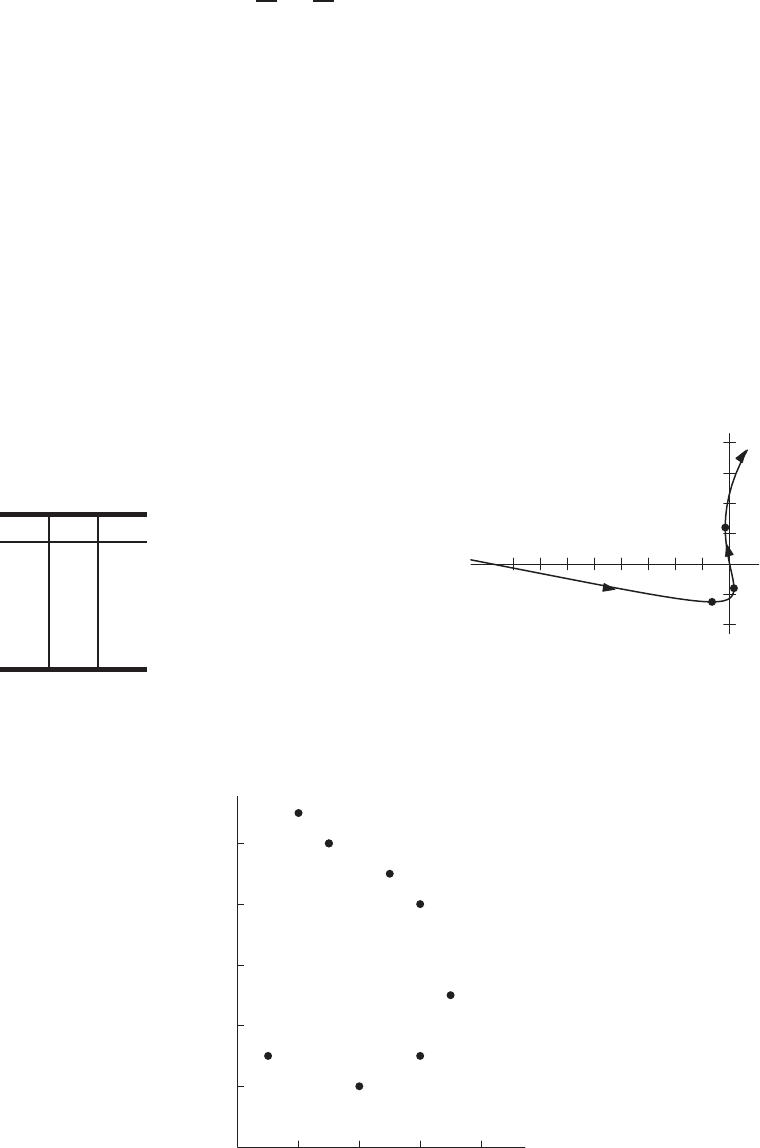
1600 Chapter Seventeen /SOLUTIONS
24. The velocity vector for this motion is
~v =dx
dt~
i+dy
dt ~
j= (3t2−12)
~
i+ (2t+ 10)~
j .
The motion is vertical when the component in the~
idirection is 0 and motion in ~
jdirection is not 0. Motion in~
idirection
is 0 when
3t2−12 = 0,
t= 2,−2.
At these times, motion in ~
jdirection is not 0. The motion is horizontal when the component in the ~
jdirection is 0 and
motion in~
idirection is not 0. Motion in ~
jdirection is 0 when
2t+ 10 = 0,
t=−5.
At this time, the motion in~
idirection is not 0. To determine the end behavior, recall that a polynomial is approximated by
its highest powered term for large values (positive or negative) of the independent variable. Thus, as t→ ±∞, we have
x≈t3and y≈t2. The end behavior, and the xand ycoordinates when the motion is vertical or horizontal, are shown in
Table 17.2. The graph is shown in Figure 17.6.
Table 17.2
t x y
−∞ −∞ +∞
−5−65 −25
−2 16 −16
2−16 24
+∞+∞+∞
−800 −400
−40
40
80
x
y
Figure 17.6
25. Plotting the positions on the xy plane and noting their times gives the graph shown in Figure 17.7.
2 4 6 8
0
2
4
6
8
10
x
y
t= 0
t= 0.5
t= 1
t= 1.5
t= 2
t= 2.5,3.5
t= 3
t= 4
Figure 17.7

17.2 SOLUTIONS 1601
(a) We approximate dx/dt by ∆x/∆tcalculated between t= 1.5and t= 2.5:
dx
dt ≈∆x
∆t=3−7
2.5−1.5=−4
1=−4.
Similarly,
dy
dt ≈∆y
∆t=10 −5
2.5−1.5=5
1= 5.
So,
~v (2) ≈ −4
~
i+ 5~
jand Speed =k~v k=√41.
(b) The particle is moving vertically at about time t= 1.5. Note that the particle is momentarily stopped at about t= 3;
however it is not moving parallel to the y-axis at this instant.
(c) The particle stops at about time t= 3 and reverses course.
26. (a) The vector −−→
P Q between the points is given by
−−→
P Q = 2
~
i+ 5~
j+ 3~
k .
Since ||−−→
P Q|| =√22+ 52+ 32=√38, the velocity vector of the motion is
~v =5
√38 (2
~
i+ 5~
j+ 3~
k).
(b) The motion is along a line starting at the point (3,2,−5) and with the velocity vector from part (a). The equation of
the line is
~r = 3
~
i+ 2~
j−5~
k+t~v = 3
~
i+ 2~
j−5~
k+5
√38 (2
~
i+ 5~
j+ 3~
k)t,
so
x= 3 + 10
√38 t, y = 2 + 25
√38 t, z =−5 + 15
√38 t.
27. (a) The particle starts at (2,−1,5) so ~r 0= 2
~
i−~
j+ 5~
k. In 5 seconds, the particle moves through a displacement given
by −−→
P Q = 3
~
i+ 4~
j−6~
k. Its velocity, ~v , is given by
~v =3
5~
i+4
5~
j−6
5~
k= 0.6
~
i+ 0.8~
j−1.2~
k .
Thus, the equation of the motion is
~r = 2
~
i−~
j+ 5~
k+t(0.6
~
i+ 0.8~
j−1.2~
k)
or
x= 2 + 0.6t, y =−1 + 0.8t, z = 5 −1.2t
where 0≤t≤5.
(b) The velocity vector in part (a), ~v = 0.6
~
i+ 0.8~
j−1.2~
k, means that the particle is moving with
Speed =||~v || =p(0.6)2+ (0.8)2+ (1.2)2= 1.562.
To make the speed equal 5, take a new velocity vector given by
~v =5
1.562 (0.6
~
i+ 0.8~
j−1.2~
k) = 1.92
~
i+ 2.56~
j−3.84~
k .
Thus, the equation of the motion is
~r = 2
~
i−~
j+ 5~
k+t(1.92
~
i+ 2.56~
j−3.84~
k)
or
x= 2 + 1.92t, y =−1 + 2.56 t, z = 5 −3.84t.
The particle reaches Q= (5,3,−1) when
2 + 1.92t= 5
or t= 1.56 seconds. The parametric equations describe the motion from Pto Qwhen 0≤t≤1.56.

1602 Chapter Seventeen /SOLUTIONS
28. (a) We substitute x= 1 + t, y = 5 + 2t, z =−7 + tinto x+y+z= 1 and solve for t:
(1 + t) + (5 + 2t) + (t−7) = 1
4t−1 = 1
t= 0.5sec.
When t= 0.5, the particle is at the point (x, y, z) = (1 + (0.5),5 + 2(0.5),(0.5) −7) = (1.5,6,−6.5).
(b) The particle’s velocity is
~v =~
i+ 2~
j+~
k ,
so
Speed =||12+ 22+ 12|| =√6meters/sec.
29. (a) At t= 0, we have ~r (0) = 0
~
i+ 0~
j+ 6.4~
k, so the stone’s initial position is (0,0,6.4). Thus the rooftop is 6.4
meters above the ground.
(b) The stone hits the ground when the height above the ground is 0; that is, when its zcoordinate is 0:
6.4−4.9t2= 0
t=±r6.4
4.9=±1.14.
Since tmust be positive, the stone hits the ground about 1.14 seconds after it is thrown.
(c) The velocity of the stone at time tis given by
~v (t) = ~r ′(t) = 10
~
i−5~
j−9.8t~
k ,
so when the stone hits the ground at t= 1.14 seconds,
~v (1.14) = 10
~
i−5~
j−9.8(1.14)~
k= 10
~
i−5~
j−11.172~
k .
The stone’s speed is given by ||~v (1.14)|| =√102+ 52+ 11.1722= 15.81 meters/sec.
(d) The stone hits the ground at the point with position vector
~r (1.14) = 10(1.14)
~
i−5(1.14)~
j+ (6.4−4.9(1.14)2)~
k ,
which is the point (11.4,−5.7,0).
(e) The acceleration of the stone at time tis given by
~a (t) = ~v ′(t) = −9.8~
k .
Thus, the acceleration is constant; the stone hits the ground at an acceleration of −9.8meters/sec2; that is 9.8 meters/sec2
downward.
30. (a) Since z= 90 feet when t= 0, the tower is 90 feet high.
(b) The child reaches the bottom when z= 0, so t= 90/5 = 18 minutes.
(c) Her velocity is given by
~v =d~r
dt =−(10 sin t)
~
i+ (10 cos t)~
j−5~
k ,
so
Speed =||~v || =p(−10 sin t)2+ (10 cos t)2+ (−5)2=p102+ 52=√125 ft/min.
(d) Her acceleration is given by
~a =d~v
dt =−(10 cos t)
~
i−(10 sin t)~
jft/min2.
31. (a) The height at time tis given by z= 100 −(t−5)2, so the maximum height occurs at t= 5 secs, when r=
10
~
i+ 15~
j+ 100~
k, so the point is (10,15,100).
(b) The velocity of the particle at time tis given by
~v = 2
~
i+ 3~
j−2(t−5)~
k ,
so the speed is
||~v || =p22+ 32+ 22(t−5)2=p13 + 4(t−5)2cm/sec.
Thus, the maximum speed occurs when t= 0 secs and when t= 10 secs and is given by ||~v || =p13 + 4(52) =
√113 = 10.630 cm/sec.
(c) The minimum speed occurs when t= 5 and is given by ||~v || =√13 = 3.606 cm/sec.
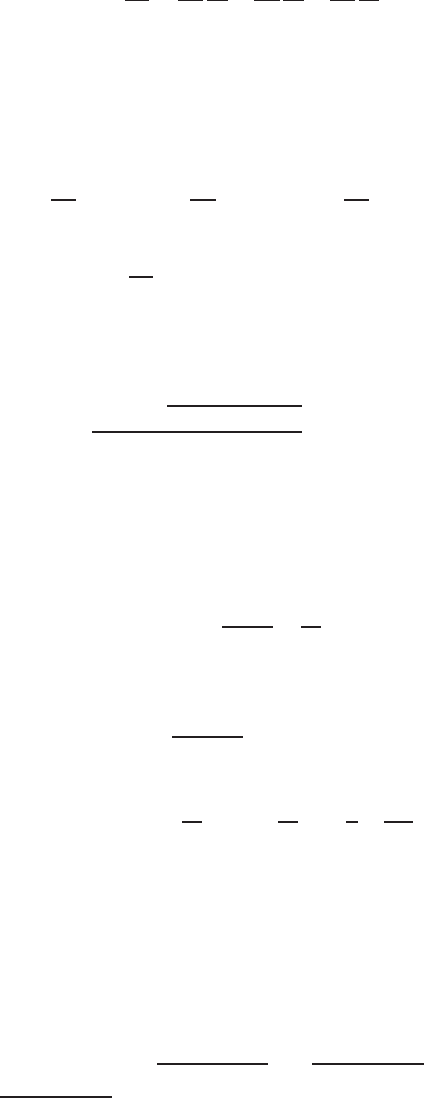
17.2 SOLUTIONS 1603
32. We want dw/dt at t= 0. The chain rule gives
dw
dt =∂w
∂x
dx
dt +∂w
∂y
dy
dt +∂w
∂z
dz
dt .
Since ~r ′(0) = 2
~
i+ 3~
j+ 6~
kand
~r ′(t) = x′(t)
~
i+y′(t)~
j+z′(t)~
k ,
we have
x′(0) = 2, y′(0) = 3, z′(0) = 6.
Since grad f= 4
~
i−3~
j+~
kat the point (7,2,5) which the particle reaches at time t= 0, we have
∂w
∂x (7,2,5)
= 4,∂w
∂y (7,2,5)
=−3,∂w
∂z (7,2,5)
= 1.
Thus dw
dt t=0
= 4 ·2−3·3 + 1 ·6 = 5
33. (a) The ball hits the ground when y= 0, so
2 + 25t−4.9t2= 0.
The quadratic formula gives
t=−25 ±p252−4·2(−4.9)
−2(4.9) =−0.079 or 5.181 sec.
We need the positive answer, t= 5.181 sec.
(b) At the time the ball hits the ground, x= 20(5.181) = 103.616 meters. Thus, the ball hits the ground after 5.181
seconds at a point 103.616 meters horizontally from where it was thrown.
(c) h= 2 meters.
(d) g= 9.8meters/sec2.
(e) Since vcos θ= 20 and vsin θ= 25, we have
tan θ=vsin θ
vcos θ=25
20 = 1.25,
so
θ= arctan(1.25) = 0.896.
Then
v=20
cos 0.896 = 32.016 meters/sec.
34. (a) To eliminate t, substitute t=x/20 into the equation for z. This gives
z= 5 x
20 −0.5x
20 2
=x
4−x2
800 .
(b) To decide when the particle is at ground level, set the equation for zequal to 0 and solve for t:
5t−0.5t2= 0
−0.5t(t−10) = 0,
so t= 0 and t= 10 seconds.
(c) The particle’s velocity is ~v =x′(t)
~
i+z′(t)~
k, so
~v = 20
~
i+ (5 −t)~
k .
(d) The particle’s speed is
||~v || =p202+ (5 −t)2=p400 + (5 −t)2m/s.
(e) No. The quantity p400 + (5 −t)2is never 0.
(f) The particle is at its highest point halfway between the times when it is at ground level, or when t= 5. Alternatively,
the highest point occurs when z′= 0, that is
z′(t) = 5 −t= 0 so t= 5 seconds.
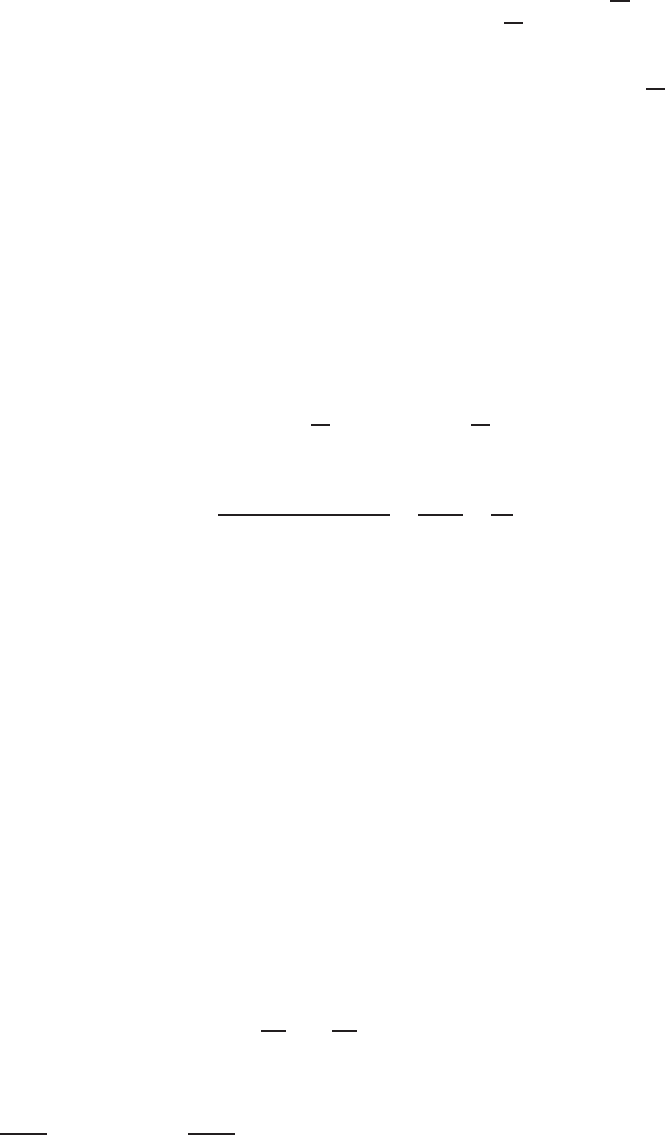
1604 Chapter Seventeen /SOLUTIONS
35. (a) The top of the tower is at the point (0,0,20), so we want ~r (0) = 20~
k. This is (I) and (IV). Only (IV) is going
downward.
Projectile (IV) hits the ground when z= 0, which occurs when 20 −t2= 0, so t=√20 = 4.5. (We take the
positive root since the projectile is launched when t= 0.) At this time, ~r (√20) = 8.9~
j, so the projectile hits the
ground at the point (0,8.9,0), which is 8.9meters from the base of the tower in the direction of the tree.
(b) To hit the top of the tree, the projectile must go through the point (0,20,20). This is (II).
The projectile reaches the top of the tree when 2t2= 20, so (taking the positive root) t=√10 = 3.2sec. The
projectile is launched from ~r (0) = ~
0, the base of the tower.
(c) Projectiles launched from somewhere on the tower have x(0) = y(0) = 0 and 0≤z(0) ≤20. Only (III) and (V)
have nonzero x(0) and y(0).
To hit the tree, there must be a time for which the projectile is at a point (0,20, z)for some 0≤z≤20.
Since (III) has x(t) = 20 for all t, it does not hit the tree. So (V) is the answer.
For (V), we have 2t= 20, when t= 10 sec. Then ~r (10) = 20~
j+ 10~
k, so the projectile hits the tree at
(0,20,10), which is half way up.
36. (a) For any positive constant k, the parameterization
x=−5 sin(kt)y= 5 cos(kt)
moves counterclockwise on a circle of radius 5 starting at the point (0,5). We choose kto make the period 8 seconds.
If k·8 = 2π, then k=π/4and the parameterization is
x=−5 sin πt
4y=5 cos πt
4.
(b) Since it takes 8 seconds for the particle to go around the circle
Speed =Circumference of circle
8=2π(5)
8=5π
4cm/sec.
37. Since the acceleration due to gravity is −9.8m/sec2, we have ~r ′′(t) = −9.8~
k. Integrating gives
~r ′(t) = C1
~
i+C2~
j+ (−9.8t+C3)~
k ,
~r (t) = (C1t+C4)
~
i+ (C2t+C5)~
j+ (−4.9t2+C3t+C6)~
k .
The initial condition, ~r (0) = ~
0, implies that C4=C5=C6= 0, thus
~r (t) = C1t
~
i+C2t~
j+ (−4.9t2+C3t)~
k .
To find the position vector, we need to find the values of C1, C2,and C3. This we do using the coordinates of the
highest point. When the rocket reaches its peak, the vertical component of the velocity is zero, so −9.8t+C3= 0. Thus,
at the highest point, t=C3/9.8. At that time
~r (t) = 1000
~
i+ 3000~
j+ 10000~
k ,
so, for the same value of t:
C1t= 1000,
C2t= 3000,
−4.9t2+C3t= 10,000,
Substituting t=C3/9.8into the third equation gives
−4.9C3
9.82
+C2
3
9.8= 10,000
C2
3= 2(9.8)10,000
C3= 442.7
Then C1=1000
C3/9.8= 22.1and C2=3000
C3/9.8= 66.4.Thus,
~r (t) = 22.1t
~
i+ 66.4t~
j+ (442.7t−4.9t2)~
k .
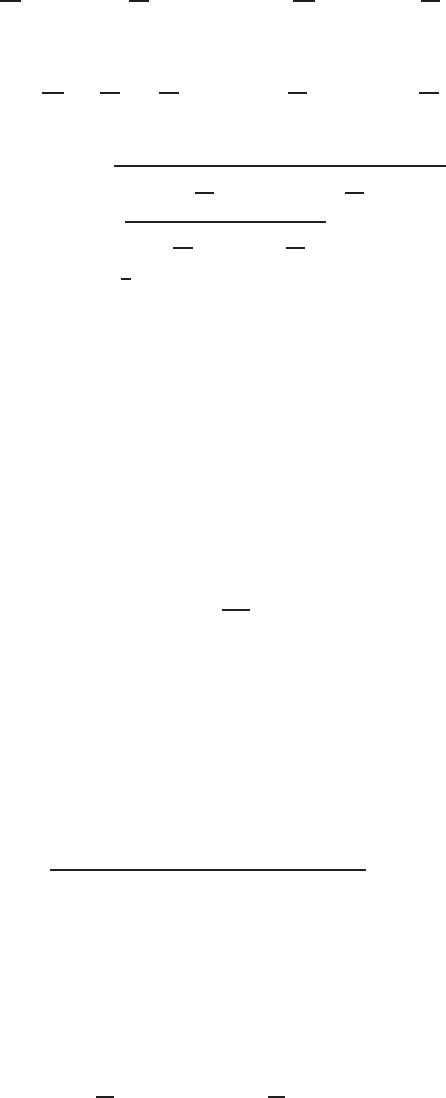
17.2 SOLUTIONS 1605
38. (a) The parametric equation describing Emily’s motion is
x= 10 cos 2π
20 t= 10 cos π
10 t, y =10 sin 2π
20 t= 10 sin π
10 tz=constant.
Her velocity vector is
~v =dx
dt~
i+dy
dt ~
j+dz
dt ~
k=−πsin π
10 t~
i+πcos π
10 t~
j .
Her speed is given by:
k~v k=r−πsin π
10 t2
+πcos π
10 t2
+ 02
=πrsin2π
10 t+ cos2π
10 t
=π√1 = πm/sec,
which is independent of time (as we expected). This is certainly the long way to solve this problem though, since we
could have simply divided the circumference of the circle (20π)by the time taken for a single rotation (20 seconds)
to arrive at the same answer.
(b) When Emily drops the ball, it initially has Emily’s velocity vector, but it immediately begins accelerating in the z-
direction due to the force of gravity. The motion of the ball will then be tangential to the merry-go-round, curving
down to the ground. In order to find the tangential component of the ball’s motion, we must know Emily’s velocity
at the moment she dropped the ball. Then we can integrate the velocity and obtain the position of the ball. Assuming
Emily drops the ball at time t= 0, her position and velocity vector are
~r (0) = 10
~
i+ 3~
kand ~v (0) = π~
j .
Thus, the ball has velocity only in the y-direction when it is dropped. In the z-direction, we have
Acceleration =d2z
dt2=−9.8m/sec2.
Since the initial velocity 0and initial height 3, we have
z= 3 −4.9t2.
The ball touches the ground when z= 0, that is, when t= 0.78 sec. In that time, the ball also travels π(0.78) = 2.45
meters in the y-direction. So, the final position is (10,2.45,0). The distance between this point and P= (10,0,0)
is 2.45 meters.
(c) The distance of the ball from Emily when it hits the ground is found by finding Emily’s position at t= 0.78 sec and
using the distance formula. Emily’s position when the ball hits the ground is (10 cos(0.078π),10 sin(0.078π),3) =
(9.70,2.43,3). The distance between this point and the point where the ball struck the ground is:
d≈p(10 −9.70)2+ (2.45 −2.43)2+ (0 −3)2= 3.01 meters.
Note that the merry-go-round does not rotate very much in the 0.78 sec needed for the ball to reach the ground, so
our answer makes sense.
39. Since the particle moves in a circle of radius awe have ||~r (t)|| =aso
~r (t)·~r (t) = a2.
Differentiating with respect to tgives
d
dt~r (t)·~r (t) + ~r (t)·d
dt~r (t) = 0
so
~r ′(t)·~r (t) = 0.
Thus, the position vector, ~r (t), and the velocity vector, ~v =~r ′(t), are perpendicular at all times t.
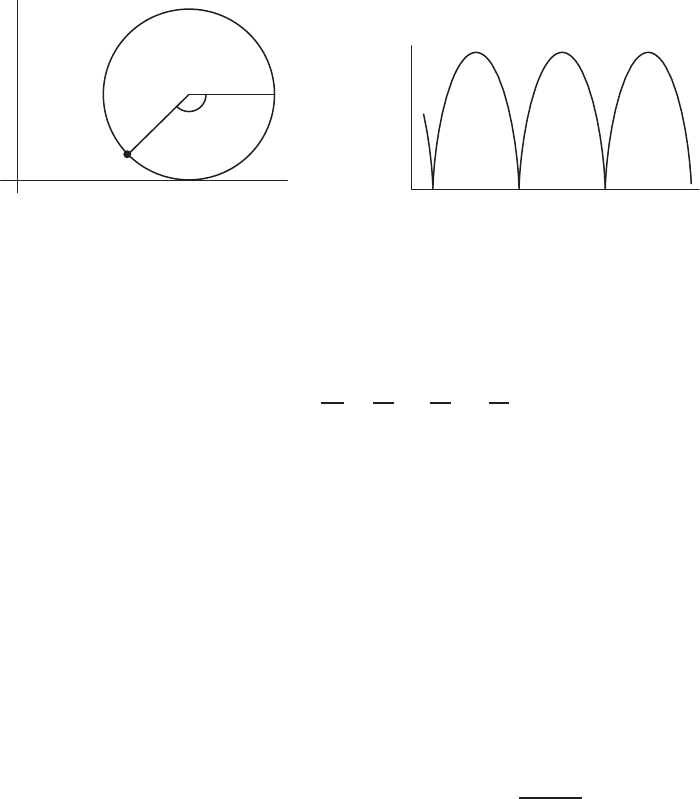
1606 Chapter Seventeen /SOLUTIONS
40. (a) The center of the wheel moves horizontally, so its y-coordinate will never change; it will equal 1at all times. In one
second, the wheel rotates 1radian, which corresponds to 1meter on the rim of a wheel of radius 1meter, and so the
rolling wheel advances at a rate of 1meter/sec. Thus the x-coordinate of the center, which equals 0at t= 0, will
equal tat time t. At time tthe center will be at the point (x, y) = (t, 1).
(b) By time tthe spot on the rim will have rotated tradians clockwise, putting it at angle −tas in Figure 17.8. The
coordinates of the spot with respect to the center of the wheel are (cos(−t),sin(−t)). Adding these to the coordinates
(t, 1) of the center gives the location of the spot as (x, y) = (t+ cos t, 1−sin t). See Figure 17.9.
(t, 1)
−t
x
y
Figure 17.8
x
y
Figure 17.9
41. (a) No. The height of the particle is given by 2t; the vertical velocity is the derivative d(2t)/dt = 2. Because this is a
positive constant, the vertical component of the velocity vector is upward at a constant speed of 2.
(b) When 2t= 10, so t= 5.
(c) The velocity vector is given by
~v (t) = d~r
dt =dx
dt~
i+dy
dt ~
j+dz
dt ~
k
=−(sin t)
~
i+ (cos t)~
j+ 2~
k .
From (b), the particle is at 10 units above the ground when t= 5, so at t= 5,
~v (5) = 0.959
~
i+ 0.284~
j+ 2~
k .
Therefore, ~v (5) = −sin(5)
~
i+ cos(5)~
j+ 2~
k.
(d) At this point, t= 5, the particle is located at
~r (5) = (cos(5),sin(5),10) = (0.284,−0.959,10).
The tangent vector to the helix at this point is given by the velocity vector found in part (c), that is, ~v (5) = 0.959
~
i+
0.284~
j+ 2~
k . So, the equation of the tangent line is
~r (t) = 0.284
~
i−0.959~
j+ 10~
k+ (t−5)(0.959
~
i+ 0.284~
j+ 2~
k).
42. We have velocity vector ~v (t) = −αsin t
~
i+αcos t~
j+β~
k. For the speed we compute
Speed = (α2cos2t+α2sin2t+β2)1/2=pα2+β2
which does not depend on t.
43. (a) Let the ant begin the trip at time t= 0, and let’s place the origin of our coordinate system at the center of the disk.
We align the axes so that at time t= 0 the radius along which the ant crawls falls on the positive x-axis. At time t
seconds, the ant is at a distance of r=tcm from the origin and at angle θ= 2πt radians from the positive x-axis.
The Cartesian coordinates of this point are (x, y) = (rcos θ, r sin θ) = (tcos(2πt), t sin(2πt)). We can write the
parametric equations of the ant’s motion in vector form as
~r (t) = tcos(2πt)
~
i+tsin(2πt)~
j , 0≤t≤100.

17.2 SOLUTIONS 1607
(b) The velocity vector of the ant is the derivative
~v (t) = ~r ′(t) = (cos(2πt)−2πt sin(2πt))
~
i+ (sin(2πt) + 2πt cos(2πt))~
j .
The speed is the magnitude of the velocity vector
k~v k= ((cos(2πt)−2πt sin(2πt))2+ (sin(2πt) + 2πt cos(2πt))2)1/2
= (1 + 4π2t2)1/2cm/sec.
Observe that the speed of the ant is increasing. Even though the ant is crawling at constant rate on the disk, the turning
of the disk moves the ant faster and faster as it gets closer to the edge.
(c) The acceleration vector is
~a =~v ′(t) = (−4πsin(2πt)−4π2tcos(2πt))
~
i+ (4πcos(2πt)−4π2tsin(2πt))~
j .
The magnitude of the acceleration is
k~a k= ((−4πsin(2πt)−4π2tcos(2πt))2+ (4πcos(2πt)−4π2tsin(2πt))2)1/2
= 4π(1 + π2t2)1/2cm/sec2.
44. (a) Since x=Rcos(ωt)and y=Rsin(ωt), and x2+y2=R2cos2(ωt) + R2sin2(ωt) = R2, we have motion around
a circle of radius Rcentered at the origin. The particle moves counterclockwise, completing one revolution in time
2π/ω. Thus, the period = 2π/ω.
(b) The velocity vector is
~v =d~r
dt =−ωR sin(ωt)
~
i+ωR cos(ωt)~
j .
We expect the velocity, ~v , to be tangent to the circle. To verify that this, we compute
~v ·~r = (−ωR sin(ωt)
~
i+ωR cos(ωt)~
j)·(Rcos(ωt)
~
i+Rsin(ωt)~
j)
=−ωR2sin(ωt) cos(ωt) + ωR2cos(ωt) sin(ωt) = 0.
This shows that the velocity vector is perpendicular to the radius from the center of the circle to the particle, which
moves counterclockwise.
The speed is k~v k=ωR, which is constant. Notice that this makes sense, because in time 2π/ω, the particle
travels a distance of 2πR, giving a speed of 2πR/(2π/ω) = ωR.
(c) The acceleration vector is
~a =d~v
dt =−ω2Rcos(ωt)
~
i−ω2Rsin(ωt)~
j=−ω2~r .
The acceleration vector points in the direction opposite to the position vector ~r , and thus points toward the center of
the circle. It has constant magnitude k~a k=ω2R=kvk2/R.
45. (a) Let xrepresent horizontal displacement (in cm) from some starting point and ythe distance (in cm) above the ground.
Since
25 km/hr =25 ·105
602= 694.444 cm/sec,
if tis in seconds, the motion of the center of the pedal is given by
x
~
i+y~
j= 694.444t
~
i+ 30~
j .
The circular motion of your foot relative to the center is described by
h
~
i+k~
j= 20 cos(2πt)
~
i+ 20 sin(2πt)~
j ,
so the motion of the light on your foot relative to the ground is described by
x
~
i+y~
j= (694.444t+ 20 cos(2πt))
~
i+ (30 + 20 sin(2πt))~
j .

1608 Chapter Seventeen /SOLUTIONS
(b) See Figure 17.10.
600 1200
20
40
x
y
Figure 17.10
(c) Suppose your pedal is rotating with angular velocity ωradians/sec, so that the motion is described by
x
~
i+y~
j= (694.444t+ 20 cos ωt)
~
i+ (30 + 20 sin ωt)~
j .
The light moves backward if dx/dt is negative. Since
dx
dt = 694.444 −20ωsin ωt,
the minimum value of dx/dt occurs when ωt =π/2, and then
dx
dt = 694.444 −20ω < 0
giving
ω≥34.722 radians/sec.
Since there are 2πradians in a complete revolution, an angular velocity of 34.722 radians/sec means 34.722/2π≈
5.526 revolutions/sec.
46. At time tobject Bis at the point with position vector ~r B(t) = ~r A(2t), which is exactly where object Ais at time 2t.
Thus Bvisits the same points as A, but does so at different times; Agets there later. While Bcovers the same path as A,
it moves twice as fast. To see this, note for example that between t= 1 and t= 3, object Bmoves along the path from
~r B(1) = ~r A(2) to ~r B(3) = ~r A(6) which is traversed by object Aduring the time interval from t= 2 to t= 6. It takes
Atwice as long to cover the same ground.
In the case where ~r A(t) = t
~
i+t2~
j, both objects move on the parabola y=x2. Both Aand Bare at the origin at
time t= 0, but Barrives at the point (2,4) at time t= 1, whereas Adoes does not get there until t= 2.
47. In uniform circular motion the velocity vector is tangent to the circle of motion and the acceleration vector is directed
toward the center of the circle. At all times the velocity ~v and acceleration ~a are perpendicular. Since ~v ·~a = (2
~
i+~
j)·
(
~
i+~
j) = 3 6= 0,~v and ~a are not perpendicular, and so the object can not be in uniform circular motion.
48. The acceleration vector points from the object to the center of the orbit, and the velocity vector points from the object
tangent to the circle in the direction of motion. From Figure 17.11 we see that the movement is counterclockwise.
~a
~v
Center of orbit
Figure 17.11
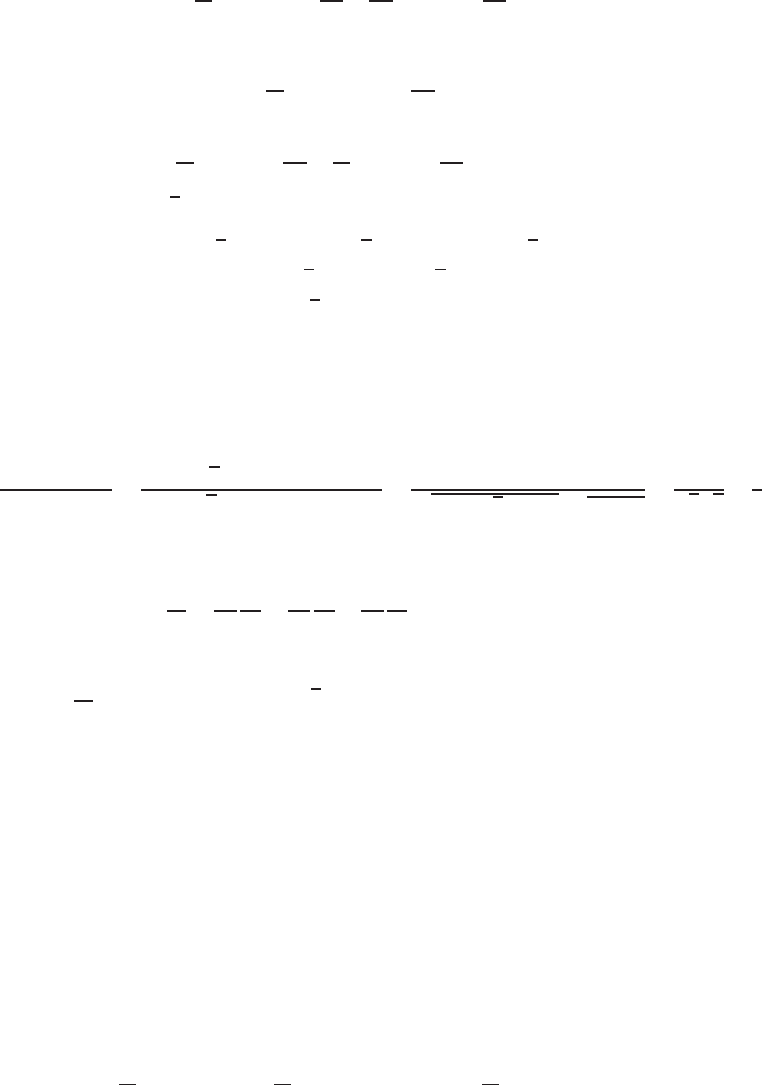
17.2 SOLUTIONS 1609
49. (a) Using the product rule for differentiation we get
d
dt (~r ·~r ) = ~r ·d~r
dt +d~r
dt ·~r = 2~r ·d~r
dt .
(b) Since ~a is a constant, d~a /dt = 0 so the product rule gives
d
dt (~a ×~r ) = ~a ×d~r
dt .
(c) The product rule gives
d
dt (r3~r ) = r3d~r
dt +d
dt (r3)~r =r3d~r
dt + 3r2~r .
50. (a) Since grad f(1,7,2) = ~
i−(√6)~
j+~
kis normal to the tangent plane, and since the plane goes through the point
(1,7,2), an equation is
x−√6y+z= 1 ·1−√6·7 + 1 ·2 = 3 −7√6
x−√6y+z= 3 −7√6.
(b) A vector normal to the level surface is ~n =~
i−(√6)~
j+~
k. The curve Cpass through the point (1,7,2) at t= 0,
so we find the tangent to the curve at this point:
~r ′(t) = 2(t+ 1)
~
i−7 sin t~
j+ 2et~
k ,
~r ′(0) = 2
~
i−7·0~
j+ 2e0~
k= 2
~
i+ 2~
k .
The angle, θ, between ~n and ~r ′(0) is given by
cos θ=~n ·~r ′(0)
||~n || · ||~r ′(0)|| =(
~
i−(√6)~
j+~
k)·(2
~
i+ 2~
k)
||~
i−(√6)~
j+~
k|| · ||2
~
i+ 2~
k|| =1·2 + 1 ·2
p12+ (√6)2+ 12·√22+ 22=4
√8√8=1
2.
Thus, θ= arccos(1/2) = π/3.
(c) By the chain rule, the rate at which the concentration, c, is changing is
dc
dt =∂f
∂x
dx
dt +∂f
∂y
dy
dt +∂f
∂z
dz
dt = grad f·~r ′(t).
Thus, at t= 0,
dc
dt = grad f·~r ′(0) = (
~
i−(√6)~
j+~
k)·(2
~
i+ 2~
k) = 4 ppm per second.
51. Since ~v =scos θ~
i+ssin θ~
j, the unit vector in the direction of ~v is
~
T= cos θ~
i+ sin θ~
j
and ~
N=~
k×~
T=−sin θ~
i+ cos θ~
j .
Using the chain rule to differentiate ~v with respect to t, we have
~a = (s′cos θ−s(sin θ)θ′)
~
i+ (s′sin θ+s(cos θ)θ′)~
j
=s′(cos θ~
i+ sin θ~
j) + sθ′(−sin θ~
i+ cos θ~
j)
=s′~
T+sθ′~
N .
52. Let ~
Fbe the force towards O. Then ~
Fis parallel to ~r (t)but in the opposite direction, so ~
F=−k~r (t)for some constant
k. However, by Newton’s second law, ~
F=m~a , where ~a (t) = ~r ′′(t)is the acceleration of the particle. Now consider
d
dt (~r (t)×~v (t)) = d
dt (~r (t)) ×~v (t) + ~r (t)×d
dt (~v (t))
=~v (t)×~v (t) + ~r (t)×~a (t) = ~
0.
since ~r (t)and ~a (t)are parallel and ~v (t)×~v (t) = ~
0. Thus, ~r (t)×~v (t) = ~c , a constant.
Since ~r (t)×~v (t) = ~c , the particle moves so that ~r (t)is perpendicular to ~c . Thus, ~r (t)is always in the plane
perpendicular to ~c that contains the fixed point O.
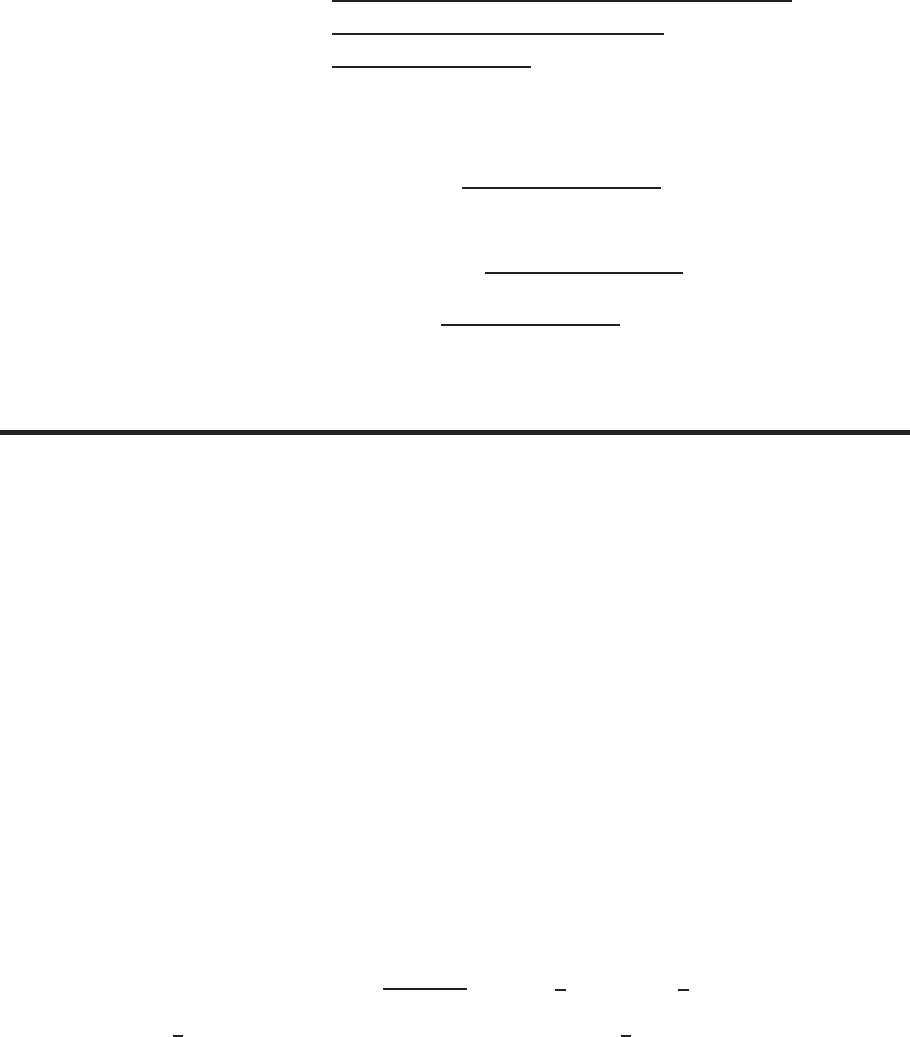
1610 Chapter Seventeen /SOLUTIONS
53. (a) If ∆t=ti+1 −tiis small enough so that Ciis approximately a straight line, then we can make the linear approxi-
mations
x(ti+1)≈x(ti) + x′(ti)∆t,
y(ti+1)≈y(ti) + y′(ti)∆t,
z(ti+1)≈z(ti) + z′(ti)∆t,
and so
Length of Ci≈p(x(ti+1)−x(ti))2+ (y(ti+1)−y(ti))2+ (z(ti+1)−z(ti))2
≈px′(ti)2(∆t)2+y′(ti)2(∆t)2+z′(ti)2(∆t)2
=px′(ti)2+y′(ti)2+z′(ti)2∆t.
(b) From point (a) we obtain the approximation
Length of C=Xlength of Ci
≈Xpx′(ti)2+y′(ti)2+z′(ti)2∆t.
The approximation gets better and better as ∆tapproaches zero, and in the limit the sum becomes a definite integral:
Length of C= lim
∆t→0Xpx′(ti)2+y′(ti)2+z′(ti)2∆t
=Zb
apx′(t)2+y′(t)2+z′(t)2dt.
Strengthen Your Understanding
54. Velocity and acceleration are orthogonal for uniform circular motion, which is motion at constant speed. If the speed is
not constant, then velocity and acceleration are not orthogonal. For example, if
~r (t) = (cos t2)
~
i+ (sin t2)~
j
then
~v (t)·~a (t) = 4t6= 0.
55. Acceleration is a vector, not a scalar.
56. The length of the parameter interval is not the same as the length of the curve parameterized. The length of the curve is
given by
Length =ZB
Ak~
v(t)kdt.
57. The particle with position
~r (t) = t+ 2t2~
i+ 2t~
j+ 3t2~
k
has velocity ~v (0) = ~
i+ 2~
jand acceleration ~a (0) = 4
~
i+ 6~
k.
58. The curve
~r (t) = cos t
~
i+ sin t~
j+t~
k , a ≤t≤b
with velocity
~v (t) = −sin t
~
i+ cos t~
j+~
k
has
Length =Zb
ap~v (t)·~v (t)dt =Zb
a
√2dt = (b−a)√2.
If b−a= 10/√2, the length is 10. For example, the interval 0≤t≤10/√2corresponds to a piece of the helix of
length 10.
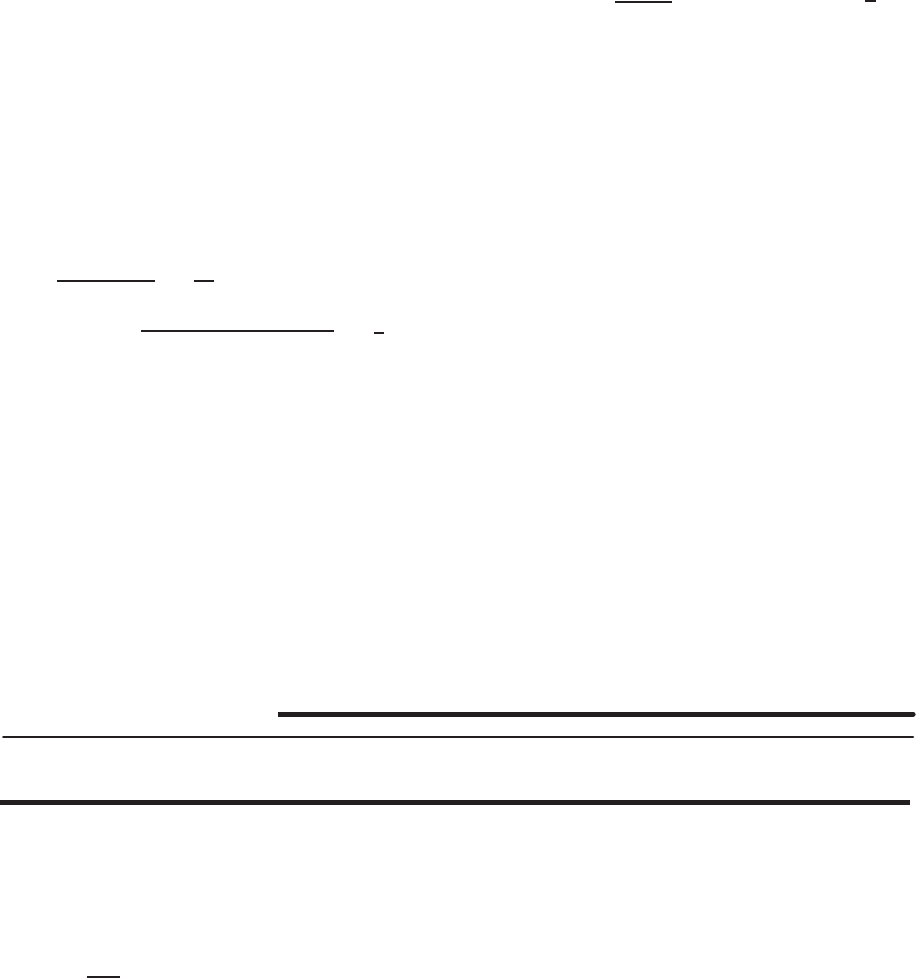
17.3 SOLUTIONS 1611
59. False. The velocity vector is ~v (t) = ~r ′(t) = 2t
~
i−~
j . Then ~v (−1) = −2
~
i−~
jand ~v (1) = 2
~
i−~
j, which are not
equal.
60. True. The velocity vector is ~v (t) = ~r ′(t) = 2t
~
i−~
j , so the speed is s(t) = √4t2+ 1.Then s(−1) = s(1) = √5.
61. False. While this is true for motion in a circle with constant speed, it is not true in general. For a counterexample, consider
motion along a parabola ~r (t) = t
~
i+t2~
j. Then ~v (t) = ~
i+ 2t~
jand ~a (t) = 2~
j . Taking the dot product gives
~v (t)·~a (t) = 4t, which is not zero for all t. Thus the velocity and acceleration vectors are not always perpendicular.
62. False. If a particle is moving along a line with nonconstant speed, then the acceleration and velocity vectors are parallel.
For a counterexample, consider motion along the line ~r (t) = t2
~
i+t2~
j. Then ~v (t) = 2t
~
i+ 2t~
jand ~a (t) = 2
~
i+ 2~
j ,
so ~v (t) = t~a (t).Thus in this case the velocity vector and acceleration vectors are parallel at all points.
63. False. As a counterexample, consider the curve ~r (t) = t2
~
i+t2~
jfor 0≤t≤1. In this case, when tis replaced by −t,
the parameterization is the same, and is not reversed.
64. True. The length of the curve Cis given by Rb
a||~v (t)||dt =Rb
a1dt =b−a.
65. False. The velocity of the particle is given by ~v (t) = ~r ′(t) = 3
~
i+ 2~
j+~
k, so speed is constant: ||~v (t)|| =
√32+ 22+ 12=√14.So the particle never stops.
66. False. As a counterexample, consider motion along the helix ~r (t) = cos t
~
i+ sin t~
j+t~
k . In this case the speed is
||~v (t)|| =p(−sin t)2+ (cos t)2+ 12=√2.Thus the particle has constant speed, but is traveling along a helix, not a
line.
67. True. We find the tangent vector to a parametrically defined curve by differentiating ~r (t).
68. False. Suppose ~r (t) = (cos t)
~
i+ (sin t)~
j, so ~r (t)traces out the unit circle. Then ~r (t)lies along the radius of the circle
and
~r ′(t) = (−sin t)
~
i+ (cos t)~
j
and ~r ′(t)is tangent to the circle. Thus ~r (t)and ~r ′(t)are perpendicular, so their cross product is not zero.
69. False. Suppose ~r (t) = t
~
i+t~
j. Then ~r ′(t) = ~
i+~
jand
~r ′(t)·~r (t) = (t
~
i+t~
j)·(
~
i+~
j) = 2t.
So ~r ′(t)·~r (t)6= 0 for t6= 0.
70. False. This result is true for uniform circular motion, but is not true in general.
Solutions for Section 17.3
Exercises
1. ~
V=x
~
i
2. ~
V=−y~
i
3. ~
V=x
~
i+y~
j=~r
4. ~
V=−y~
i+x~
j
5. ~
V=−x
~
i−y~
j=−~r
6. ~
V=~r
k~r k: vectors are of unit length and point outward.
7. (a) Parallel to y-axis.
(b) Length increasing in x-direction.
(c) Length not dependent on y.
8. (a) Not parallel to either axis.
(b) Length does not change as xincreases.
(c) The length increases as yincreases.
9. (a) Parallel to x-axis
(b) Length increases as xincreases
(c) Length decreases as yincreases.

1612 Chapter Seventeen /SOLUTIONS
10. (a) Since grad(x4+e3y) = 4x3
~
i+ 3e3y~
j, the vector field is parallel to neither axis.
(b) The length increases as xincreases.
(c) The length increases as yincreases.
11. See Figure 17.12.
x
y
Figure 17.12
:~
F(x, y) = 2
~
i+ 3~
j
12. See Figure 17.13.
x
y
Figure 17.13
:~
F(x, y) = y~
i
13. See Figure 17.14.
x
y
Figure 17.14
:~
F(x, y) = −y~
j

17.3 SOLUTIONS 1613
14. See Figure 17.15.
x
y
Figure 17.15
:~
F(~r ) = 2~r
15. See Figure 17.16.
x
y
Figure 17.16
:~
F(~r ) = ~r
k~r k
16. See Figure 17.17.
Figure 17.17
:~
F(~r ) = −~r /k~r k3
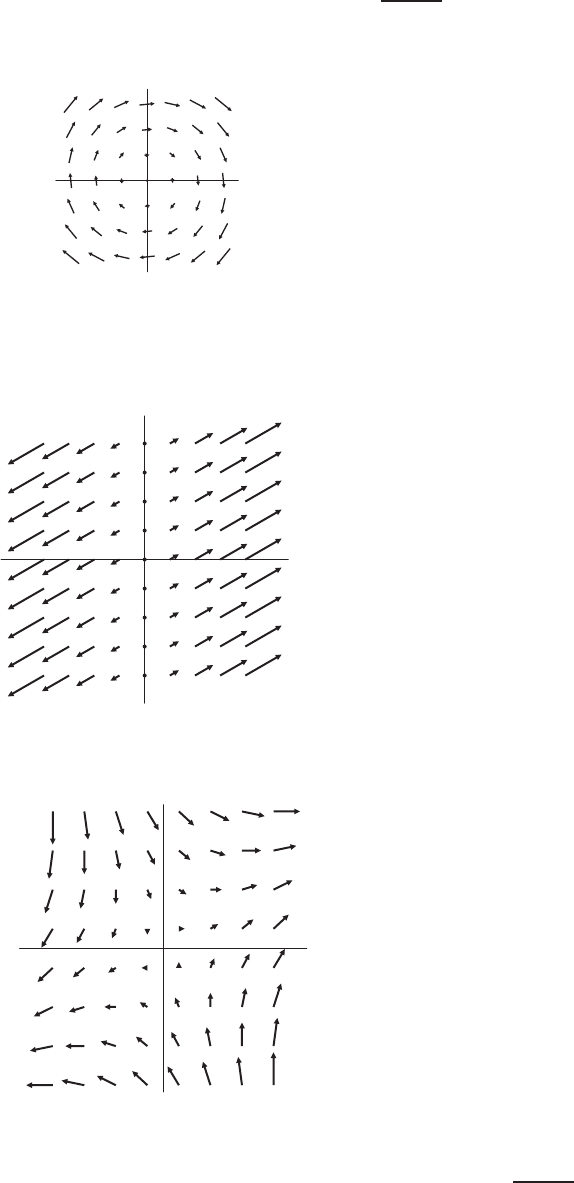
1614 Chapter Seventeen /SOLUTIONS
17. The vector field points in a clockwise direction around the origin. Since ky~
i−x~
jk=py2+x2, the vectors get longer
as you go away from the origin. See Figure 17.18.
x
y
Figure 17.18
18. See Figure 17.19.
x
y
Figure 17.19
:~
F(x, y) = 2x
~
i+x~
j
19.
x
y
Figure 17.20
:~
F(x, y) = (x+y)
~
i+(x−y)~
j
20. (a) III. The vector field ~r points outward and increases in length farther from the origin.
(b) II. The vector field −y~
i+x~
jis tangent to a circle centered at the origin. Since || − y~
i+x~
j|| =px2+y2, the
vector field given has length 1 everywhere.
(c) IV. The vector field −~r points toward the origin and increases in length farther from the origin.
(d) VI. The vector field y~
i−x~
jis tangent to a circle centered at the origin and points clockwise.

17.3 SOLUTIONS 1615
21. Notice that for a repulsive force, the vectors point outward, away from the particle at the origin, for an attractive force, the
vectors point toward the particle. So we can match up the vector field with the description as follows:
(a) IV
(b) III
(c) I
(d) II
Problems
22. ~
F(x, y) = a
~
i+b~
jfor any real numbers aand bis a constant vector field. For example, ~
F(x, y) = 3
~
i−4~
j.
23. If ~
F(x, y) = f(x, y)~v , where f(x, y)is any positive nonconstant function and ~v is any nonzero vector, then ~
Fhas
nonconstant magnitude k~
Fk=fk~v k. It has constant direction because all its vectors are in the same direction as ~v . For
example ~
F(x, y) = (1 + x2)(3
~
i+ 2~
j).
24. If
~
F(x, y) = 1
pf(x, y)2+g(x, y)2(f(x, y)
~
i+g(x, y)~
j),
then ~
fhas constant magnitude k~
Fk= 1. For many choices of fand gthe vector field ~
Fis nonconstant because its
direction is nonconstant. For example,
~
F(x, y) = 1
√1 + x2(
~
i−x~
j).
25. Many answers are possible. For example, ~
F(x, y) = x
~
i+y~
jhas nonconstant magnitude k~
Fk=px2+y2. Its
direction is also nonconstant, since ~
F(1,0) = ~
iand ~
F(0,1) = ~
j.
26. If ~
F(x, y) = f(x, y)((1 + y2)
~
i−(x+y)~
j)where f(x, y)is any function, then ~
F·~
G= 0, which shows that ~
Fis
perpendicular to ~
G.
For example ~
F(x, y) = (y+ cos x)((1 + y2)
~
i−(x+y)~
j).
27. Vector fields (B) and (C) both appear to be constant, and therefore correspond to the equally spaced level curves in (I) and
(II). Since the gradient points toward increasing values of the function, (B) corresponds to (II) and (C) corresponds to (I).
Vector field (A) points away from the center, so it corresponds to (IV), which has a minimum in the center.
Vector field (D) points toward the center, so it corresponds to (III) which has a maximum at the center.
28. The sketches show that the vector fields point in different directions on the y-axis, so we examine the formulas for the
vector fields on the y-axis. On the y-axis, where x= 0, we have:
~
F(0, y) = y~
j, a vector pointing up if y > 0and down if y < 0, as in I
~
G(0, y) = −y~
i, a vector pointing left if y > 0and right if y < 0, as in II
~
H(0, y) = −y~
j, a vector pointing down if y > 0and up if y < 0, as in III
So ~
Fis I, ~
Gis II, and ~
His III.
29. The sketches show that the vector fields can be distinguished by the directions they point on the coordinate axes, so we
examine the formulas for the vector fields on the axes.
(a) ~
F(0, y) + ~
G(0, y) = −y~
i+y~
j=y(−~
i+~
j), a vector pointing up to the left if y > 0and down to the right if
y < 0, as in II.
(b) ~
F(0, y) + ~
H(0, y) = ~
0, the zero vector as in III.
(c) ~
G(0, y) + ~
H(0, y) = −y~
i−y~
j=−y(
~
i+~
j), a vector pointing down to the left if y > 0and up to the right if
y < 0, as in I and IV. ~
G(x, 0) + ~
H(x, 0) = x
~
i+x~
j=x(
~
i+~
j), a vector pointing up to the right if x > 0and
down to the left if x < 0, as in II and IV, so ~
G+~
His IV.
(d) −~
F(x, 0) + ~
G(x, 0) = −x
~
i+x~
j=x(−~
i+~
j), a vector pointing up to the left if x > 0and down to the right if
x < 0, as in I.
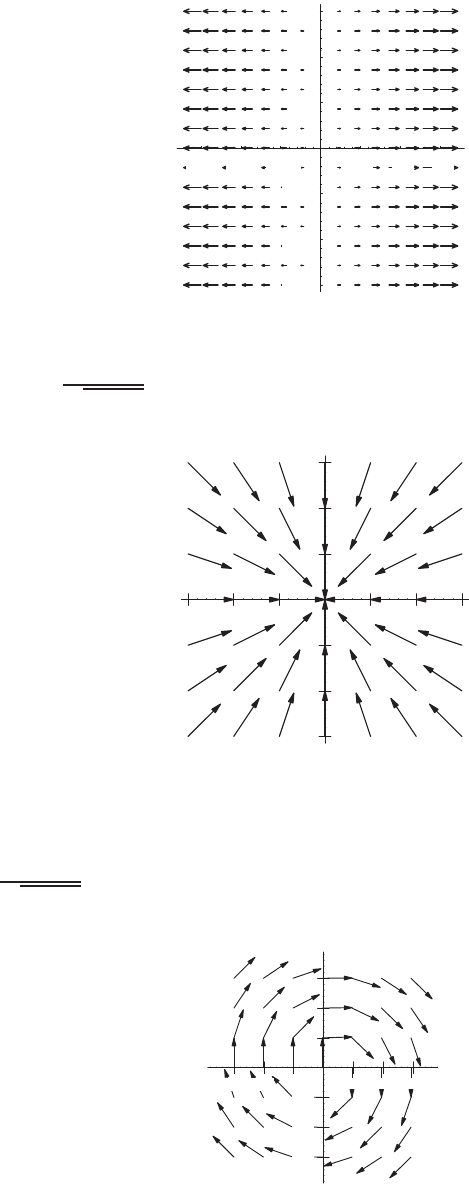
1616 Chapter Seventeen /SOLUTIONS
30. One possible solution is ~
F(x, y) = x
~
i. See Figure 17.21.
−3−2−1 1 2 3
−3
−2
−1
1
2
3
x
y
Figure 17.21
31. If we let ~
F(x, y) = −x
~
i−y~
j
px2+y2, then all vectors will be of unit length and will point toward the origin. See Figure 17.22.
−3−2−1 1 2 3
−3
−2
−1
1
2
x
y
Figure 17.22
32. The position vector at each point is ~r =x
~
i+y~
j. We want to find ~
F(x, y) = A
~
i+B~
jsuch that ~
F·~r =Ax+By = 0.
One possible answer is let A=yand B=−x. So ~
F(x, y) = y~
i−x~
j. Since the vectors are of unit length, we get
~
F(x, y) = y~
i−x~
j
px2+y2.
−3−2−1 1 2 3
−3
−2
−1
1
2
3
x
y
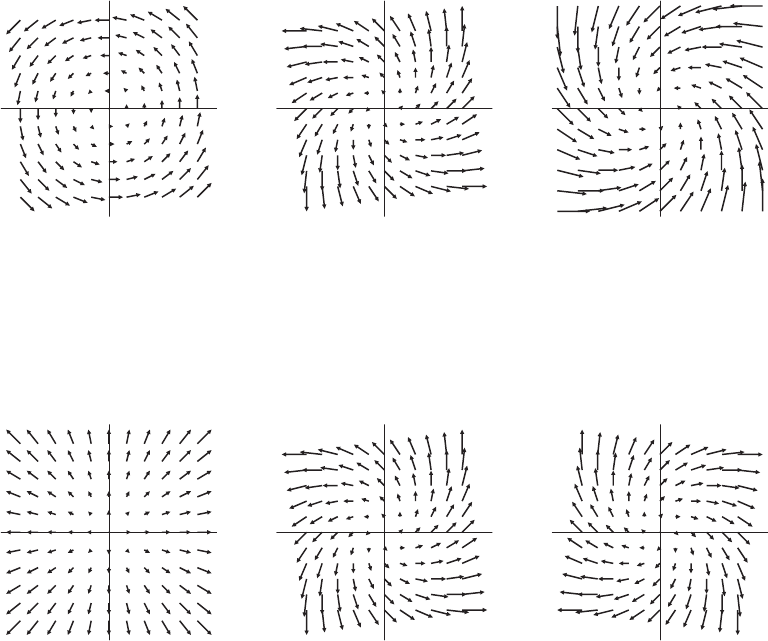
17.3 SOLUTIONS 1617
33. (a) The line lis parallel to the vector ~v =~
i−2~
j−3~
k. The vector field ~
Fis parallel to the line when ~
Fis a multiple
of ~v . Taking the multiple to be 1 and solving for x, y, z we find a point at which this occurs:
x= 1
x+y=−2
x−y+z=−3
gives x= 1,y=−3,z=−7, so a point is (1,−3,−7). Other answers are possible.
(b) The line and vector field are perpendicular if ~
F·~v = 0, that is
(x
~
i+ (x+y)~
j+ (x−y+z)~
k)·(
~
i−2~
j−3~
k) = 0
x−2x−2y−3x+ 3y−3z= 0
−4x+y−3z= 0.
One point which satisfies this equation is (0,0,0). There are many others.
(c) The equation for this set of points is −4x+y−3z= 0. This is a plane through the origin.
34. (a) The vector field ~
L= 0 ~
F+~
G=−y~
i+x~
jis shown in Figure 17.23.
(b) The vector field ~
L=a~
F+~
G= (ax −y)
~
i+ (ay +x)~
jwhere a > 0is shown in Figure 17.24.
(c) The vector field ~
L=a~
F+~
G= (ax −y)
~
i+ (ay +x)~
jwhere a < 0is shown in Figure 17.25.
x
y
Figure 17.23
x
y
Figure 17.24
x
y
Figure 17.25
35. (a) The vector field ~
L=~
F+ 0 ~
G=x
~
i+y~
jis shown in Figure 17.26.
(b) The vector field ~
L=~
F+b~
G= (x−by)
~
i+ (y+bx)~
jwhere b > 0is shown in Figure 17.27.
(c) The vector field ~
L=~
F+b~
G= (x−by)
~
i+ (y+bx)~
jwhere b < 0is shown in Figure 17.28.
x
y
Figure 17.26
x
y
Figure 17.27
x
y
Figure 17.28
36. (a) Since the velocity of the water is the sum of the velocities of the individual fields, then the total field should be
~v =~v stream +~v fountain.
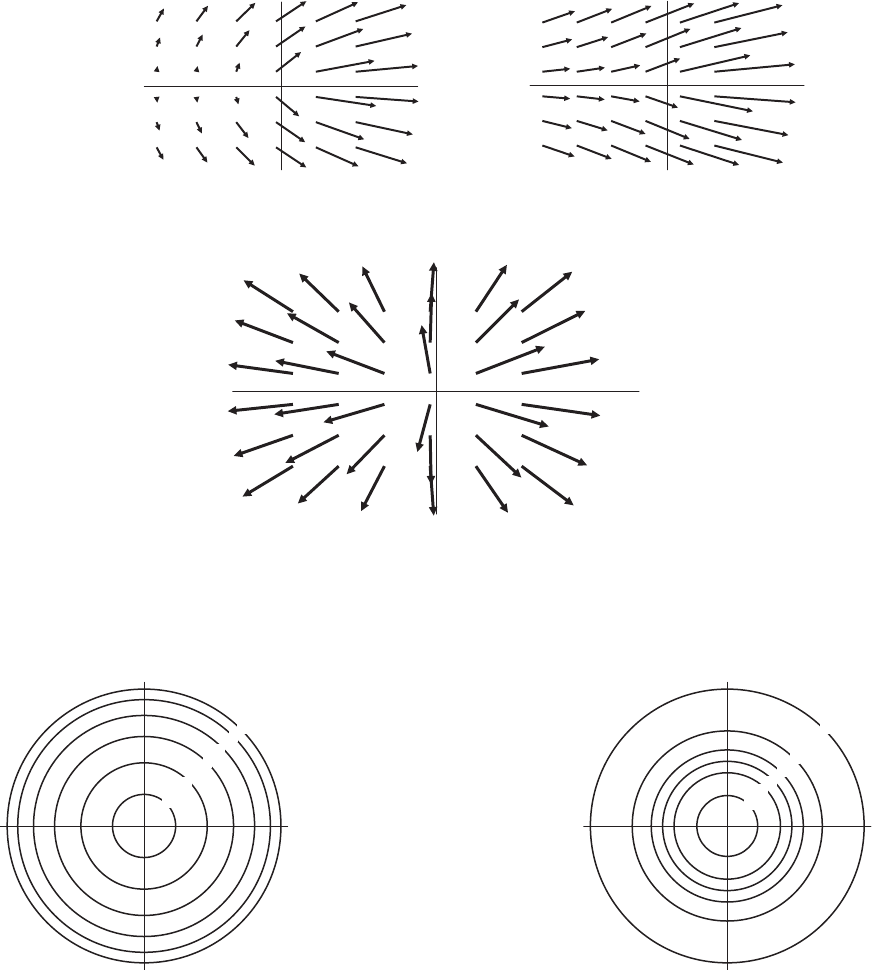
1618 Chapter Seventeen /SOLUTIONS
It is reasonable to represent ~v stream by the vector field ~v stream =A
~
i, since A
~
iis a constant vector field flowing in
the i-direction (provided A > 0). It is reasonable to represent ~v fountain by
~v fountain =K~r r/r2=K(x2+y2)−1(x
~
i+y~
j),
since this is a vector field flowing radially outward (provided K > 0), with decreasing velocity as rgets larger.
We would expect the velocity to decrease as the water from the fountain spreads out. Adding the two vector fields
together, we get
~v =A
~
i+K(x2+y2)−1(x
~
i+y~
j), A > 0, K > 0.
(b) The constants Aand Ksignify the strength of the individual components of the field. Ais the strength of the flow of
the stream alone (in fact it is the speed of the stream), and Kis the strength of the fountain acting alone.
(c)
x
y
Figure 17.29
:A= 1, K = 1
x
y
Figure 17.30
:A= 2, K = 1
x
y
Figure 17.31
:A= 0.2, K = 2
37. (a) The gradient is perpendicular to the level curves. See Figures 17.33 and 17.32. A function always increases in the
direction of its gradient; this is why the values on the level curves of fand gincrease as we approach the origin.
5
4
3210
x
y
Figure 17.32
: Level curves z=f(x, y)
54321
0
x
y
Figure 17.33
: Level curves z=g(x, y)
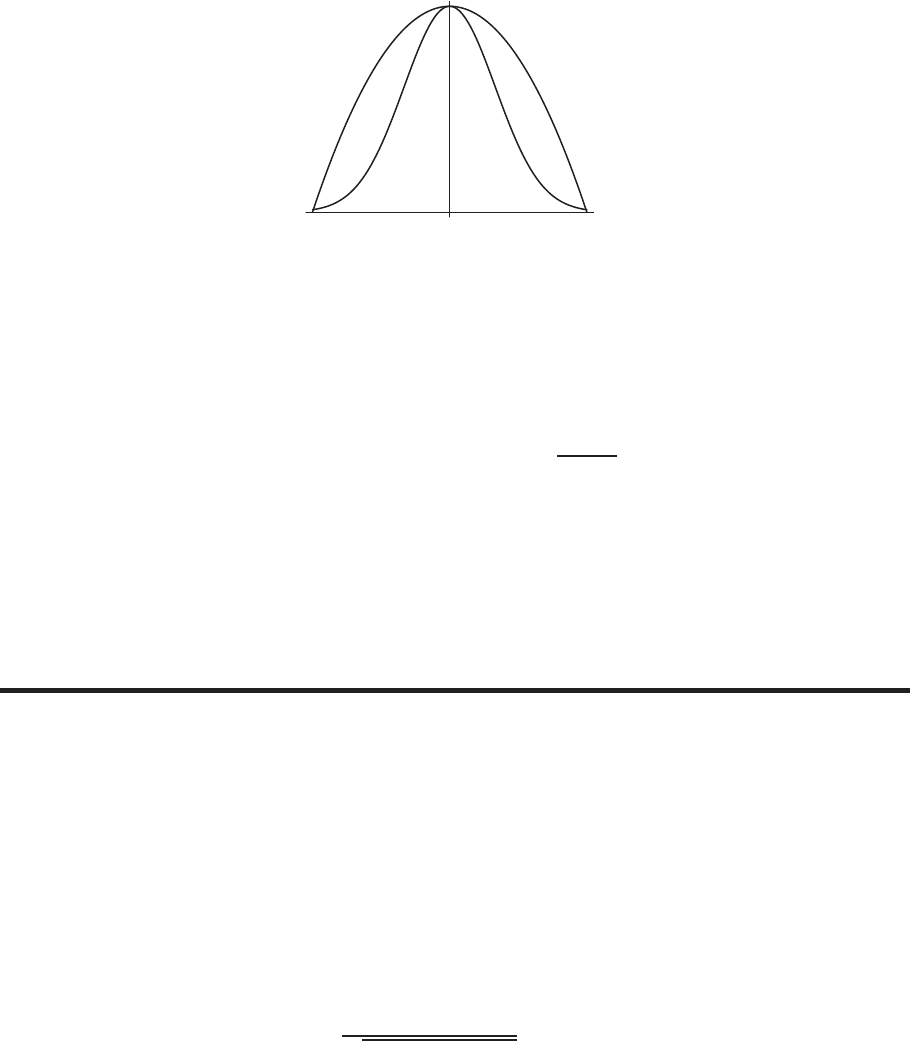
17.3 SOLUTIONS 1619
(b) fclimbs faster at outside, slower at center; gclimbs slower at outside, faster at center:
x
z
f(x, y)
g(x, y)
Figure 17.34
This can be understood if we notice that the magnitude of the gradient of fdecreases as one approaches the
origin whereas the magnitude of the gradient of gincreases (at least for a while - what happens very close to the
origin depends on the behavior of grad gin the region. One possibility for gis shown in Figure 17.34; the graph of g
could also have a sharp peak at 0or even blow up.)
38. (a) Dividing a vector ~
Fby its magnitude always produces the unit vector in the same direction as ~
F.
(b) Since
k~
Nk=k(1/F )(−v~
i+u~
j)k= (1/F )pv2+u2= (1/F )F= 1,
then ~
Nis a unit vector. We check that ~
Nis perpendicular to ~
Fusing the dot product of ~
Nand ~
F:
~
N·~
F= (1/F )(−v~
i+u~
j)·(u
~
i+v~
j) = 0.
Which side of ~
Fdoes ~
Npoint? The vector ~
kis pointing out of the diagram. Since the cross product ~
k×~
Fis
perpendicular to both ~
kand ~
F, then ~
Nlies in the xy-plane and points at a right angle to the direction of ~
F. By the
right-hand rule, ~
Npoints to the left as shown in the figure.
Strengthen Your Understanding
39. To obtain a plot of the vector field ~
G(x, y, z) = ~
F(2x, 2y, 2z), move the vectors in a plot of ~
F(x, y, z)halfway to
the origin, without changing their directions or magnitudes. For example, to plot the vector ~
G(1,2,3), move the vector
~
F(2,4,6) to the point (1,2,3).
Doubling the lengths of the arrows in the vector field ~
F(x, y, z)gives a plot of the vector field ~
H(x, y, z) =
2~
F(x, y, z).
40. The values of a vector field are vectors, not scalars. The formula ~
F(x, y, z) = x2−yz is not a vector field because the
expression x2−yz is not a vector.
41. The vector field
~
F(x, y, z) = (x2+ 1) ~
i+~
j+~
k
is nonconstant and is parallel to~
i+~
j+~
kat every point.
42. Any vector field that is not the zero vector at any point and that has nonconstant direction can be divided by its magnitude
to produce a nonconstant vector field of unit vectors. For example, we have
~
F(x, y, z) = 1
p(x2+ 1)2+z2+y2(x2+ 1)
~
i+z~
j+y~
k.
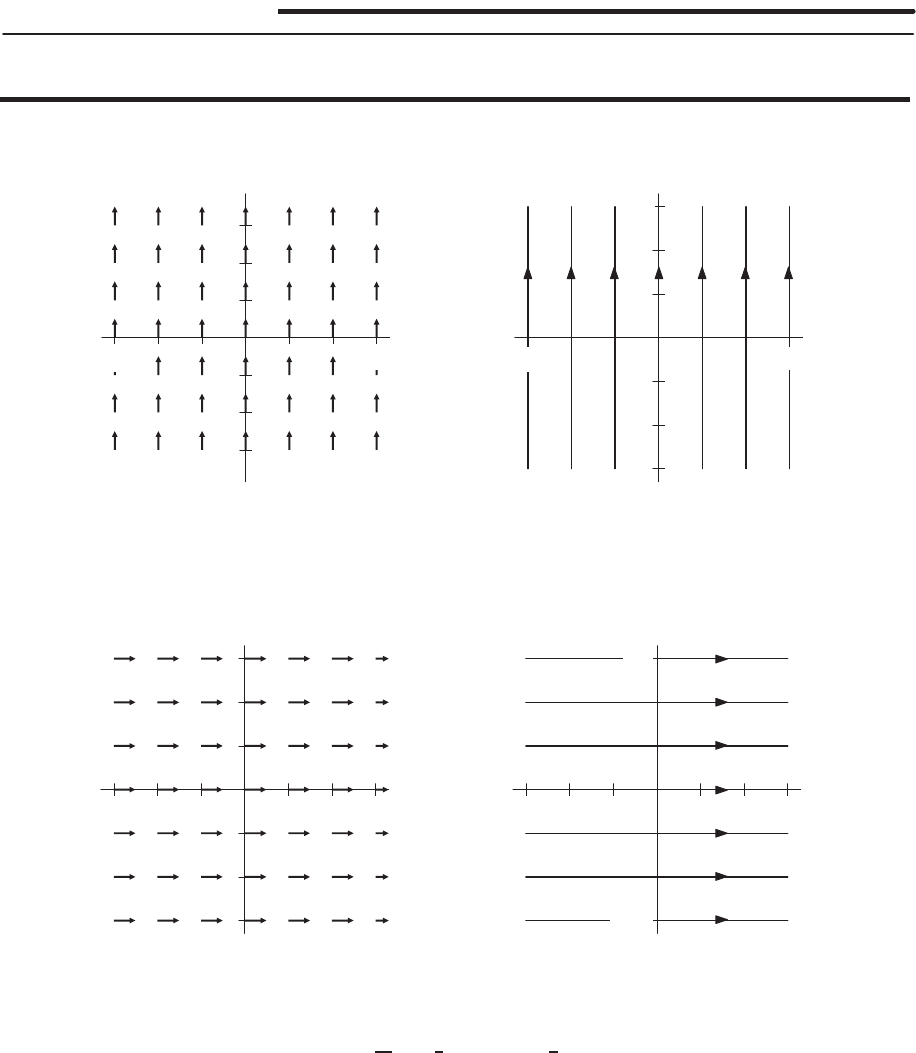
1620 Chapter Seventeen /SOLUTIONS
Solutions for Section 17.4
Exercises
1. Since x′(t) = 0 and y′(t) = 2, we have x=x0and y= 2t+y0. Thus, the solution curves are x=constant.
−12 12
−12
12
x
y
Figure 17.35
: The field ~v = 2~
j
−12 12
−12
12
x
y
Figure 17.36
: The flow x=constant
2. Since x′(t) = 3 and y′(t) = 0, we have x= 3t+x0and y=y0. Thus, the solution curves are y=constant.
−18 18
−18
18
x
y
Figure 17.37
: The field ~v = 3
~
i
−18 18
−18
18
x
y
Figure 17.38
: The flow y=constant
3. Since x′(t) = 3 and y′(t) = −2, we have x= 3t+x0and y=−2t+y0. Thus the flow lines are straight lines parallel
to the vector 3
~
i−2~
j. Alternatively, we have dy
dx =−2
3. Thus, y=−2
3x+c, where cis a constant.

17.4 SOLUTIONS 1621
−9 9
−9
9
x
y
Figure 17.39
: The field ~v = 3
~
i−2~
j
−9 9
−9
9
x
y
Figure 17.40
: The flow y=−2
3x+c
4. As
~v (t) = dx
dt~
i+dy
dt ~
j ,
the system of differential equations is (dx
dt =x
dy
dt = 0.
Since d
dt (x(t)) = d
dt (aet) = x
and d
dt (y(t)) = d
dt (b) = 0,
the given flow satisfies the system. The solution curves are the horizontal lines y=b. See Figures 17.41 and 17.42.
x
y
Figure 17.41
:~v (t) = x
~
i
−18 18
−18
18
x
y
Figure 17.42
: The flow x(t) = aet, y(t) = b
5. As
~v (t) = dx
dt~
i+dy
dt ~
j ,
the system of differential equations is (dx
dt = 0
dy
dt =x.
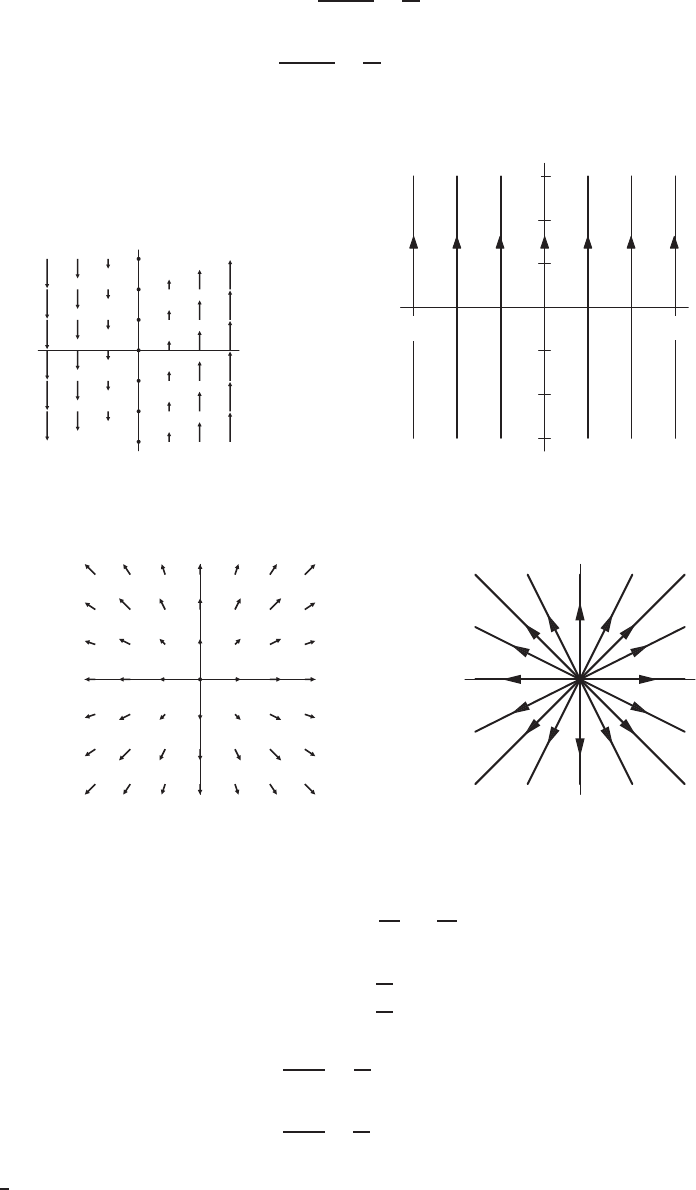
1622 Chapter Seventeen /SOLUTIONS
Since d(x(t))
dt =d
dt (a) = 0
and d(y(t))
dt =d
dt (at +b) = a=x,
the given flow satisfies the system. The solution curves are the vertical lines x=a. See Figures 17.43 and 17.44.
x
y
Figure 17.43
:~v (t) = x~
j
−12 12
−12
12
x
y
Figure 17.44
: The flow x(t) = a, y(t) = at +b
6. y
x
Figure 17.45
:~v (t) = x
~
i+y~
j
x
y
Figure 17.46
: The flow x=aet,
y=bet.
As
~v (t) = dx
dt~
i+dy
dt ~
j ,
the system of differential equations is (dx
dt =x
dy
dt =y.
Since dx(t)
dt =d
dt [aet] = aet=x(t)
and dy(t)
dt =d
dt [bet] = bet=y(t),
the given flow satisfies the system. By eliminating the parameter tin x(t)and y(t), the solution curves obtained are
y=b
ax.
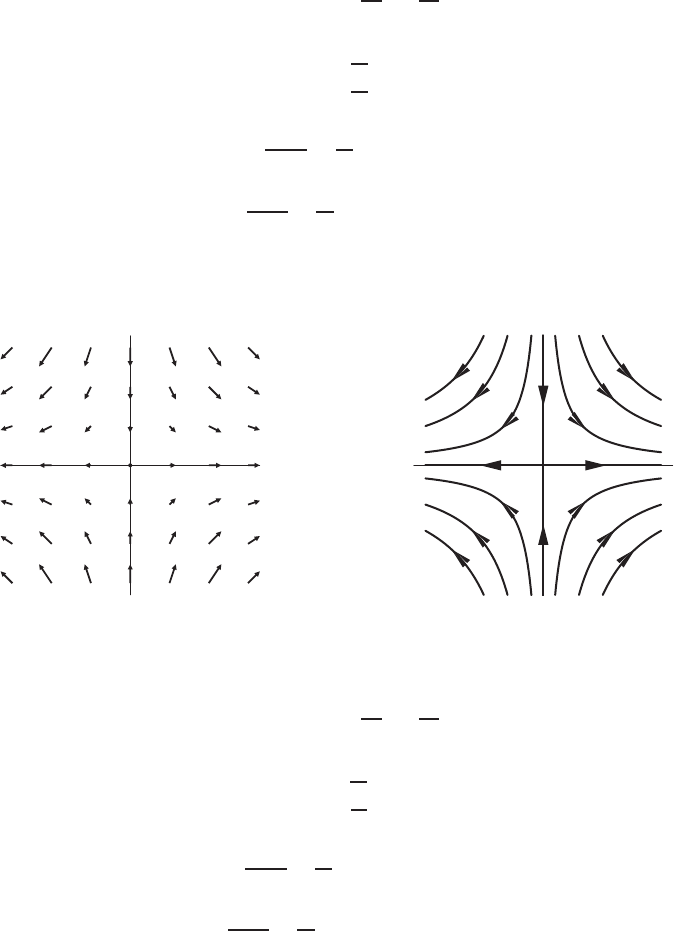
17.4 SOLUTIONS 1623
7. As
~v (t) = dx
dt~
i+dy
dt ~
j ,
the system of differential equations is (dx
dt =x
dy
dt =−y.
Since dx(t)
dt =d
dt [aet] = aet=x(t)
and dy(t)
dt =d
dt [be−t] = −be−t=y(t),
the given flow satisfies the system. By eliminating the parameter tin x(t)and y(t), the solution curves obtained are
xy =ab. See Figures 17.47 and 17.48.
x
y
Figure 17.47
:~v (t) = x
~
i−y~
j
x
y
Figure 17.48
: The flow x=aet,y=be−t
8. As
~v (t) = dx
dt~
i+dy
dt ~
j ,
the system of differential equations is (dx
dt =y
dy
dt =−x.
Since dx(t)
dt =d
dt [asin t] = acos t=y(t)
and dy(t)
dt =d
dt [acos t] = −asin t=−x(t),
the given flow satisfies the system. By eliminating the parameter tin x(t)and y(t), the solution curves obtained are
x2+y2=a2. See Figures 17.49 and 17.50.

1624 Chapter Seventeen /SOLUTIONS
y
x
Figure 17.49
:~v (t) = y~
i−x~
j
y
x
Figure 17.50
: The flow x=asin t,
y=acos t
9. As
~v (t) = dx
dt~
i+dy
dt ~
j ,
the system of differential equations is (dx
dt =y
dy
dt =x.
Since dx(t)
dt =d
dt [a(et+e−t)] = a(et−e−t) = y(t)
and dy(t)
dt =d
dt [a(et−e−t)] = a(et+e−t) = x(t),
the given flow satisfies the system. By eliminating the parameter tin x(t)and y(t), the solution curves obtained are
x2−y2= 4a2. See Figures 17.51 and 17.52.
x
y
Figure 17.51
:~v (t) = y~
i+x~
j
x
y
Figure 17.52
: The flow
x(t) = a(et+e−t), y(t) = a(et−e−t)
10. The vector field is given by ~v =y2
~
i+ 2x2~
j, that is, the flow line (x(t),(y(t)) satisfies
x′(t) = y2
y′(t) = 2x2
We’ll use Euler’s method with ∆t= 0.1to find the parameterized curve (x(t), y(t)) through (1,2). So
xn+1 =xn+ 0.1y2
n
yn+1 =yn+ (0.1)2x2
n.
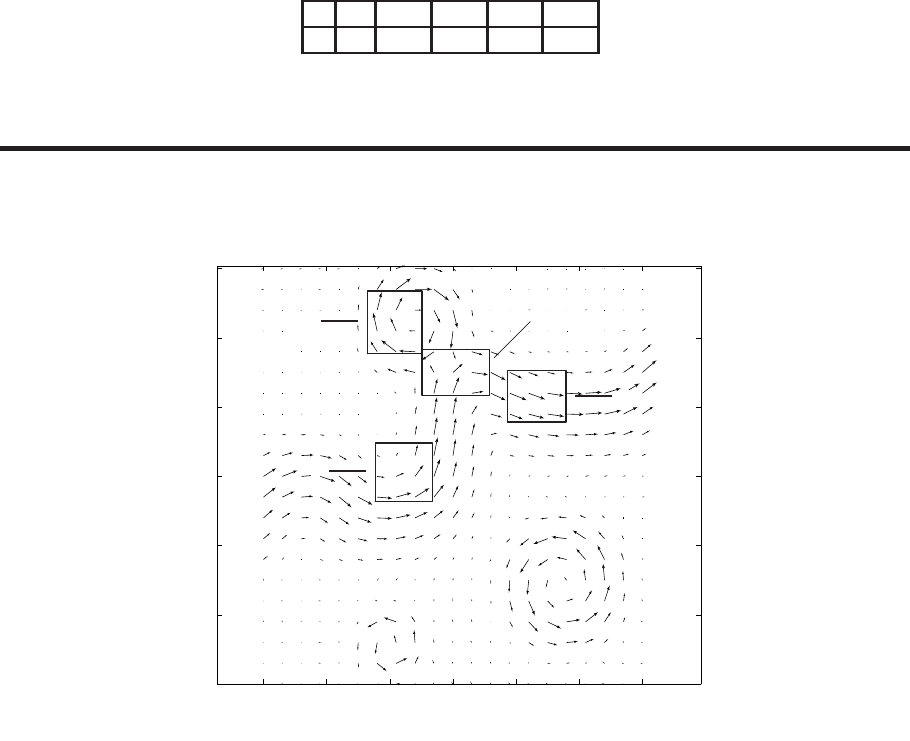
17.4 SOLUTIONS 1625
Initially, that is when t= 0, we have (x0, y0) = (1,2). Then
x1=x0+ 0.1y2
0= 1 + 0.1·22= 1.4
y1=y0+ 0.1·2x2
0= 2 + 0.1·2·12= 2.2.
Thus, we see that after one step, x1= 1.4and y1= 2.2. Further values are given in the Table 17.3.
Table 17.3
x1.4 1.884 2.556 3.646 5.770
y2.2 2.592 3.302 4.609 7.268
Problems
11. This corresponds to area A in Figure 17.53.
0 100 200 300 400 500 600
0
100
200
300
400
500
600
km
km
✲
A
✠
D
✛
C
✲
B
Figure 17.53
12. This corresponds to area B in Figure 17.53 in Problem 11.
13. This corresponds to area C in Figure 17.53 in Problem 11.
14. This corresponds to area D in Figure 17.53 in Problem 11.
15. (a) At every point (x, y)in the plane, the vector ~
G(x, y)has the same direction as ~
F(x, y)but ~
G(x, y)is twice as long.
For the case where ~
F(x, y) = −y~
i+x~
jsee Figures 17.54 and 17.55.
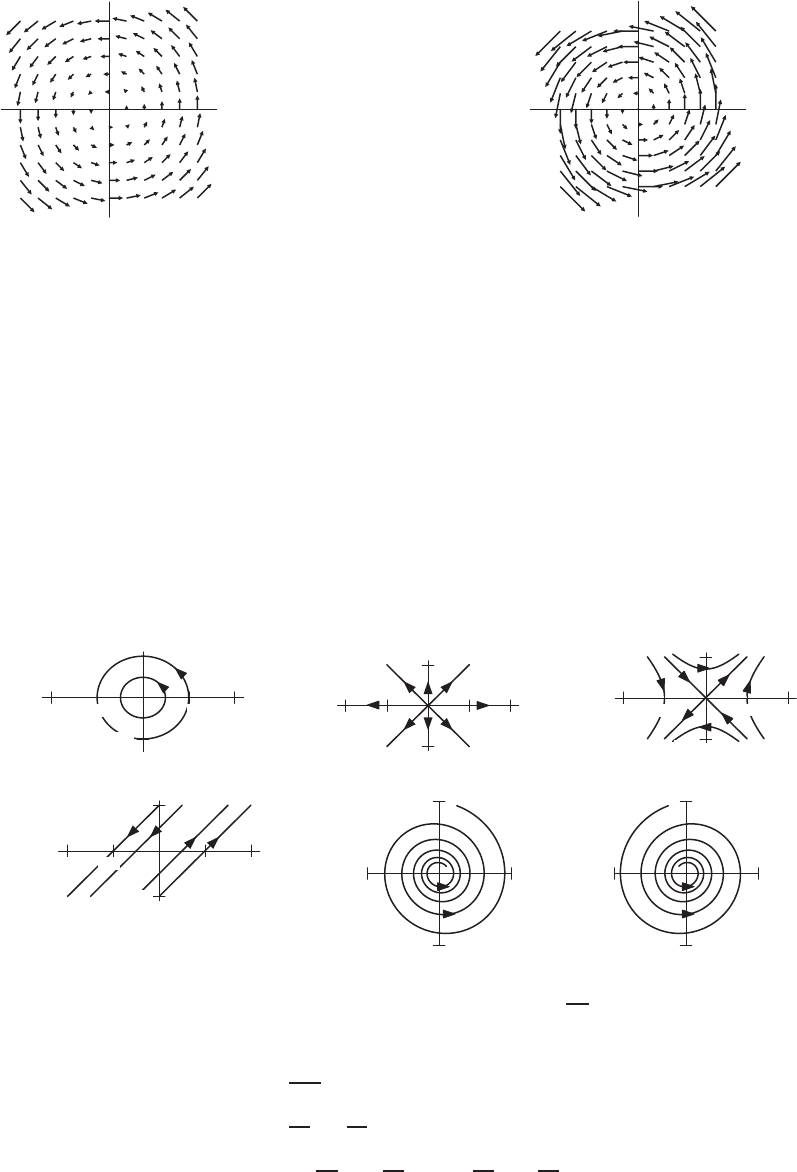
1626 Chapter Seventeen /SOLUTIONS
x
y
Figure 17.54
:~
F=−y~
i+x~
j
x
y
Figure 17.55
:G(x, y) = 2(−y~
i+x~
j)
(b) At every point in the plane the two vector fields ~
Fand ~
Ghave the same direction. Therefore the flow lines of the two
vector fields have the same slopes at every point. By the uniqueness of solutions of differential equations with initial
conditions, the flow lines of the two vector fields through any given point must be the same. This means that if two
objects are placed at the same point, one into the flow of ~
Fand the other into the flow of ~
G, they will move on exactly
the same paths. However, they will move at different speeds. The two flows will have different parameterizations.
For the case where ~
F(t) = −y~
i+x~
jboth flows are circular about the origin, but the flow of ~
Gis twice as
fast as the flow of ~
F.
16. The directions of the flow lines are as shown.
(a) III
(b) I
(c) II
(d) V
(e) VI
(f) IV
−2−1 1 2
−1
1
x
y
(I)
−2−1 1 2
−1
1
x
y
(II)
−2−1 1 2
−1
1
x
y
(III)
−2−1 1 2
−1
1
x
y
(IV)
−5 5
−5
5
x
y
(V)
−5
5
−5
5
x
y
(VI)
17. The object’s motion is described by a function ~r (t) = x(t)
~
i+y(t)~
j, where d~r
dt (t) = ~
F(x(t),y(t)) = u(x(t),
y(t))
~
i+v(x(t), y(t))~
j. Using the chain rule to differentiate, we have
~a (t) = d2~r
dt2
=du
dt~
i+dv
dt~
j
= (uxdx
dt +uydy
dt )
~
i+ (vxdx
dt +vydy
dt )~
j
= (uxu+uyv)
~
i+ (vxu+vyv)~
j
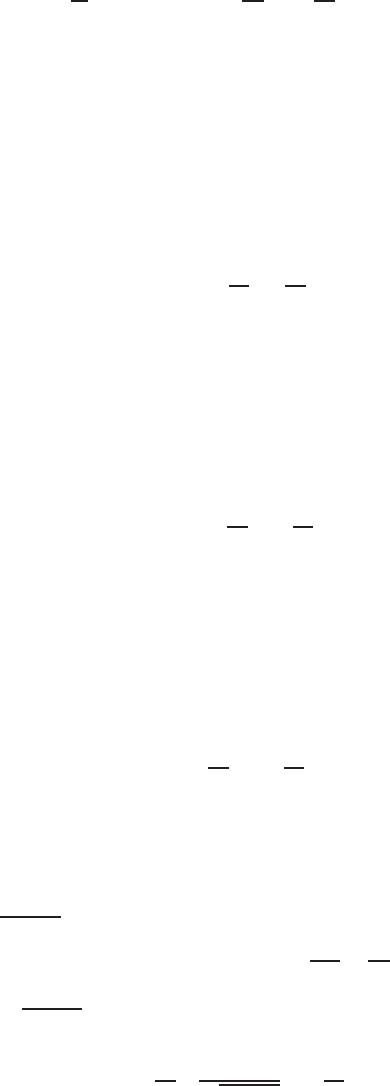
17.4 SOLUTIONS 1627
18. (a) Perpendicularity is indicated by zero dot product. We have ~v ·grad H= (−Hy
~
i+Hx~
j)·(Hx
~
i+Hy~
j) = 0.
(b) If ~r (t) = x(t)
~
i+y(t)~
jis a flow line we have, using the chain rule,
d
dt H(x(t), y(t)) = Hxdx
dt +Hydy
dt =Hx(−Hy) + Hy(Hx) = 0.
Thus H(x(t), y(t)) is constant which shows that a flow line stays on a single level curve of H.
For a different solution, use geometric reasoning. The vector field ~v is tangent to the level curves of Hbecause,
by part (a), ~v and the level curves are both perpendicular to the same vector field grad H. Thus the level curves of
Hand the flowlines of ~v run in the same direction.
19. Let ~r (t) = x(t)
~
i+y(t)~
jbe a flow line of ~v . If f(x, y)has the same value at all points (x(t), y(t)) then the flow line
lies on a level curve of f. We can check whether
g(t) = f(x(t), y(t)) = x(t)y(t)
is constant by computing the derivative g′(t). Since ~v =x
~
i−y~
j, we have dx/dt =xand dy/dt =−y. Thus,
g′(t) = xdy
dt +ydx
dt =−xy +yx = 0
and g(t)is constant. This means that the flow line lies on a level curve of f. The flow lines are parameterized hyperbolas
with equation xy =c.
20. Let ~r (t) = x(t)
~
i+y(t)~
jbe a flow line of ~v . If f(x, y)has the same value at all points (x(t), y(t)) then the flow line
lies on a level curve of f. We can check whether
g(t) = f(x(t), y(t)) = x(t)2−y(t)2
is constant by computing the derivative g′(t). Since ~v =y~
i+x~
j, we have dx/dt =yand dy/dt =x. Thus,
g′(t) = 2xdx
dt −2ydy
dt = 2xy −2yx = 0
and gis constant. This means that the flow line lies on a level curve of f. The flow lines are parameterized hyperbolas
with equation x2−y2=c.
21. Let ~r (t) = x(t)
~
i+y(t)~
jbe a flow line of ~v . If f(x, y)has the same value at all points (x(t), y(t)) then the flow line
lies on a level curve of f. We can check whether
g(t) = f(x(t), y(t)) = bx(t)2−ay(t)2
is constant by computing the derivative g′(t). Since ~v =ay~
i+bx~
j, we have dx/dt =ay and dy/dt =bx. Thus,
g′(t) = 2bx dx
dt −2ay dy
dt = 2abxy −2abyx = 0
and gis constant. This means that the flow line lies on a level curve of f. The flow lines are parameterized conic sections
with equation bx2−ay2=c, hyperbolas if aand bare both positive or both negative, and ellipses if aand bhave opposite
sign.
22. (a) Each vector in the vector field ~v is horizontal, tangent to a circle whose center is on the z-axis, and pointing coun-
terclockwise when viewed from above. Thus, ~v is parallel to −y~
i+x~
j. The point (x, y, z)is moving on a circle of
radius r=px2+y2and has
Speed = 2πr
24 =πr
12 .
Since the vector at the point (x, y, z)has magnitude πr/12 and is parallel to the unit vector
(−y~
i+x~
j)/px2+y2, we have
~v =πr
12 −y~
i+x~
j
px2+y2!=π
12 (−y~
i+x~
j)meters/hr.
(b) A point moves in a horizontal circle, centered on the z-axis, and oriented counter-clockwise when viewed from above.
These circles are the flow lines.

1628 Chapter Seventeen /SOLUTIONS
23. (a) The flow line ~r (t) = x(t)
~
i+y(t)~
jis the path with ~r ′(t) = ~v = (ax −y)
~
i+ (x+ay)~
j. Thus
x′=ax −y y′=x+ay.
We show h(t)is constant on a flow line by showing that h′(t) = 0. Using the chain rule, we have
h′(t) = e−2at(2xx′+ 2yy′)−2ae−2at(x2+y2)
=e−2at(2x(ax −y) + 2y(x+ay)) −2ae−2at(x2+y2) = 0.
The function h(t) = e−at(x2+y2)is constant because its derivative is zero.
(b) We have h(0) = ea·0(x2+y2) = 1 for points on the unit circle x2+y2= 1 at t= 0 . Hence, along the same flow
line, h(t) = e−2at(x2+y2) = 1 for all t. Thus at time t, the particle’s coordinates satisfy
x2+y2=e2at,
which is the equation of the circle of radius eat centered at the origin.
This result matches what can be seen in the vector field plot in Figure 17.56. If a < 0, the flow lines move
toward the origin. If a > 0, the flow lines move away from the origin, and if a= 0 they circle the origin.
x
y
a < 0
x
y
a= 0
x
y
a > 0
Figure 17.56
Strengthen Your Understanding
24. The vector field ~
F=−y~
i+x~
jhas linear components and circular flow lines.
25. Although the vectors in the vector field all point in the same direction, their lengths could vary. For example ~
F(x, y, z) =
(x2+ 1)
~
ihas flow lines that are all lines parallel to the x-axis pointing in the positive direction, but it is not constant.
26. Since ~r (t) = t
~
i+t2~
j+t3~
kis a flow line of the vector field ~
F(x, y, z), we have
~
F(t, t2, t3) = ~v (t) = ~
i+ 2t~
j+ 3t2~
k
where ~v (t)is the velocity of ~r (t). Let
~
F(x, y, z) = F1(x, y, z)
~
i+F2(x, y, z)~
j+F3(x, y, z)~
k .
We must determine three functions, F1,F2, and F3such that
F1(t, t2, t3) = 1 F2(t, t2, t3) = 2t F3(t, t2, t3) = 3t2.
One solution is given by
F1(x, y, z) = 1 F2(x, y, z) = 2x F3(x, y, z) = 3y.
Thus, ~r (t)is a flow line of the vector field
~
F(x, y, z) = ~
i+ 2x~
j+ 3y~
k .
27. The vector field ~
F(x, y, z) = x
~
i+y~
j+z~
kpoints away from the origin at every point other than the origin, so its flow
lines are rays pointing from the origin.
28. True, since the vectors x~
jare parallel to the y-axis.
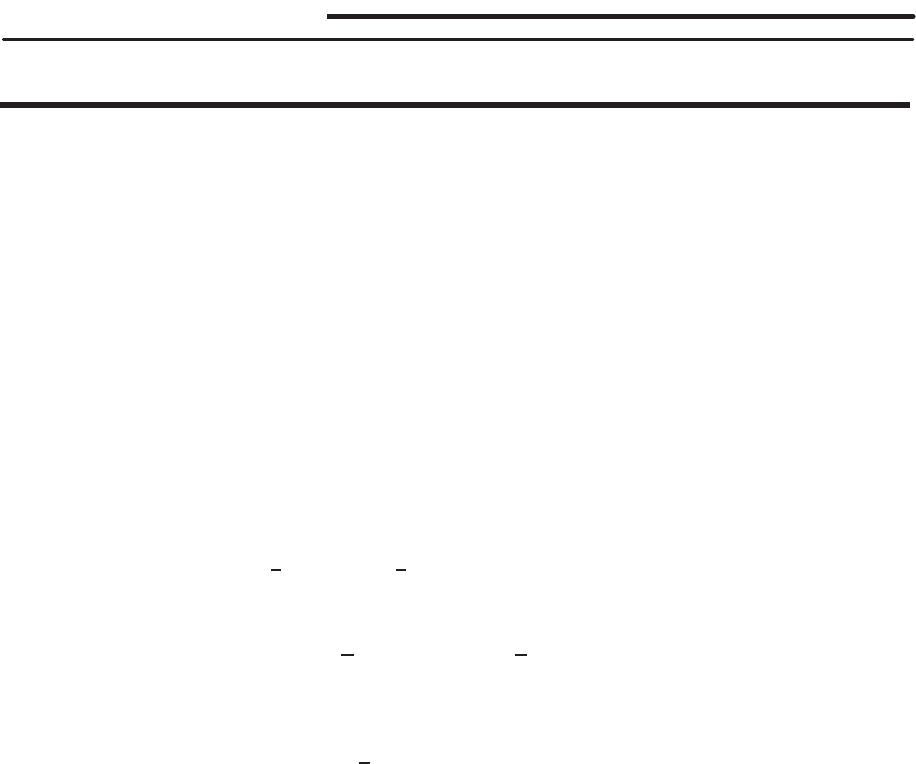
SOLUTIONS to Review Problems for Chapter Seventeen 1629
29. False. The flow lines are circles centered at the origin.
30. False. The flow lines are lines parallel to the x-axis.
31. False. Each flow line stays in the quadrant in which it originates.
32. True. Any flow line which stays in the first quadrant has x, y → ∞.
33. False. The flow lines for ~
Fare perpendicular to the contours for f, since the flow lines follow ∇f, which is perpendicular
to the contours of f.
34. True. Since a vector tangent to a circle centered at the origin is perpendicular to the radius vector ~r and ~
F(~r )is tangent
to its flow lines, ~
F(~r )must be perpendicular to ~r . Thus ~
F(~r )·~r = 0 for all ~r .
35. False. If the flow lines are all straight lines parallel to ~v , we need ~
F(x, y)to be parallel to ~v for all xand y. That
does not mean that ~
F(x, y)must be equal to ~v ; it only needs to be a scalar multiple ~v . For example, the vector field
~
F(x, y) = 6
~
i+ 10~
jhas all its flow lines parallel to ~v . Another example is ~
F(x, y) = 3ex−y
~
i+ 5ex−y~
j=ex−y~v ,
where the scalar multiplied times ~v varies as xand yvary.
36. True. If (x, y)were a point where the y-coordinate along a flow line reached a relative maximum, then the tangent vector
to the flow line, namely ~
F(x, y), there would have to be horizontal (or ~
0), that is its ~
jcomponent would have to be 0.
But the ~
jcomponent of ~
Fis always 2.
37. False. At all points on the x-axis, y= 0, so the vector field is a horizontal vector, ~
F(x, 0) = ex
~
i, pointing to the right,
since it is a positive multiple of~
i. Thus the x-axis itself is a flow line for ~
F. Since there can be only one flow line through
any point, no flow line can cross the x-axis.
Solutions for Chapter 17 Review
Exercises
1. The line has equation
~r = 2
~
i−~
j+ 3~
k+t(5
~
i+ 4~
j−~
k),
or, equivalently
x= 2 + 5t
y=−1 + 4t
z= 3 −t.
2. The displacement vector from the point (1,2,3) to the point (3,5,7) is:
3
~
i+ 5~
j+ 7~
k−(
~
i+ 2~
j+ 3~
k) = 2
~
i+ 3~
j+ 4~
k .
So the equations are
x= 1 + 2t,
y= 2 + 3t,
z= 3 + 4t.
3. x=t, y = 5.
4. The parameterization x
~
i+y~
j= 2 cos t
~
i+ 2 sin t~
jhas the right radius but starts at the point (2,0). To start at (0,2),
we need x
~
i+y~
j= 2 cos(t+π
2)
~
i+ 2 sin(t+π
2)~
j= 2 sin t
~
i+ 2 cos t~
j.
5. The parameterization x
~
i+y~
j= (4 + 4 cos t)
~
i+ (4 + 4 sin t
~
)jgives the correct circle, but starts at (8,4). To start on
the x-axis we need
x
~
i+y~
j= (4 + 4 cos(t−π
2))
~
i+ (4 + 4 sin(t−π
2))~
j= (4 + 4 sin t)
~
i+ (4 −4 cos t)~
j .
6. The parametric equation of a circle is
x= cos t, y = sin t.
When t= 0,x= 1, y = 0, and when t=π
2,x= 0, y = 1. This shows a counterclockwise movement, so our original
equation is correct.
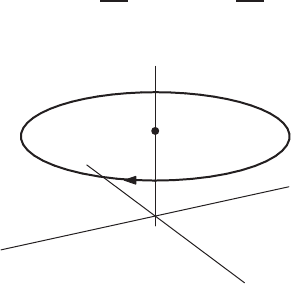
1630 Chapter Seventeen /SOLUTIONS
7. The vector (
~
i+ 2~
j+ 5~
k)−(2
~
i−~
j+ 4~
k) = −~
i+ 3~
j+~
kis parallel to the line, so a possible parameterization is
x= 2 −t, y =−1 + 3t, z = 4 + t.
8. A line perpendicular to the xz-plane will have x=constant, z=constant, y=anything: This is given by x= 1, y =
t, z = 2.
9. Since the vector ~n = grad(2x−3y+ 5z) = 2
~
i−3~
j+ 5~
kis perpendicular to the plane, this vector is parallel to the
line. Thus the equation of the line is
x= 1 + 2t, y = 1 −3t, z = 1 + 5t.
10. The xy-plane is where z= 0, so one possible answer is
x= 3 cos t, y = 3 sin t, z = 0.
This goes in the counterclockwise direction because it starts at (3,0,0) and heads in the positive y-direction.
11. Since the circle has radius 3, the equation must be of the form x= 3 cos t, y = 5, z = 3 sin t. But since the circle is being
viewed from farther out on the y-axis, the circle we have now would be seen going clockwise. To correct this, we add a
negative to the third component, giving us the equation x= 3 cos t, y = 5, z =−3 sin t.
12. We can find this equation in two ways. First we could find two points on the line of intersection and then proceed as in
Example 7 on page 921. To find two points just substitute two different values for zand solve for xand yfor each value
of z. Alternatively, assuming the line is not horizontal (which it turns out not to be), we could take zto be the parameter
t, so z=t. To find xand yas functions of twe solve the two equations for xand yin terms of t. We have
t= 4 + 2x+ 5y
t= 3 + x+ 3y.
Eliminating xwe get
−t=−2−yand y=−2 + t.
Substituting −2 + tfor yin the second equation and solving for x, we get
x= 3 −2t.
Our equations are therefore
x= 3 −2t, y =−2 + t, z =t.
or
~r =x
~
i+y~
j+z~
k= 3
~
i−2~
j+t(−2
~
i+~
j+~
k).
13. See Figure 17.57. The parameterization is
~r = 10 cos 2πt
30 ~
i−10 sin 2πt
30 ~
j+ 7~
k .
x
y
z
(0,0,7)
*
Figure 17.57
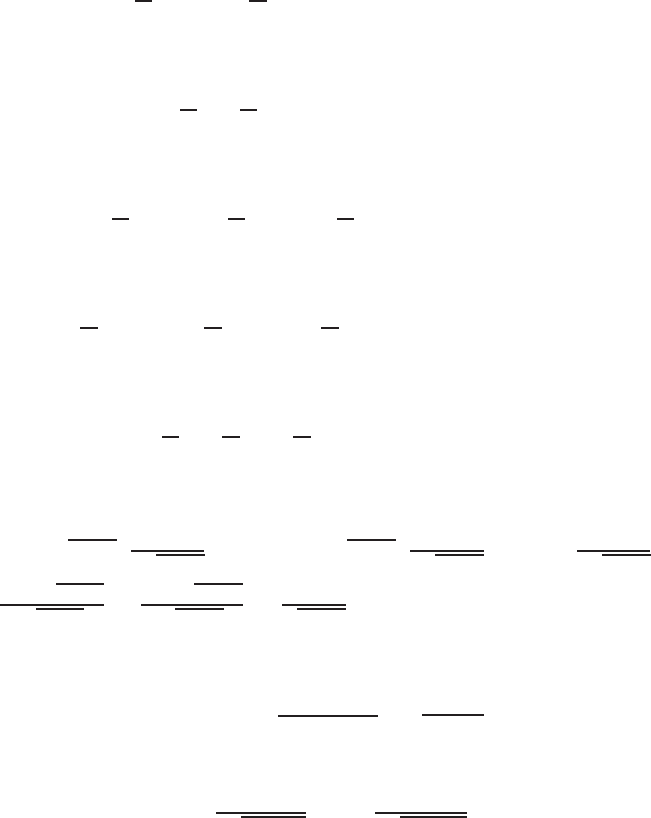
SOLUTIONS to Review Problems for Chapter Seventeen 1631
14. The velocity vector ~v is given by:
~v =d
dt (3 cos t)
~
i+d
dt (4 sin t)~
j=−3 sin t
~
i+ 4 cos t~
j .
15. The velocity vector ~v is given by:
~v =d
dt t
~
i+d
dt (t3−t)~
j=~
i+ (3t2−1)~
j .
16. The velocity vector ~v is given by:
~v =d
dt (2 + 3t)
~
i+d
dt (4 + t)~
j+d
dt (1 −t)~
k= 3
~
i+~
j−~
k .
17. The velocity vector ~v is given by:
~v =d
dt (2 + 3t2)
~
i+d
dt (4 + t2)~
j+d
dt (1 −t2)~
k= 6t
~
i+ 2t~
j−2t~
k .
18. The velocity vector ~v is given by:
~v =d
dt t
~
i+d
dt t2~
j+d
dt t3~
k=~
i+ 2t~
j+ 3t2~
k .
19. Vector. Differentiating using the chain rule gives
Velocity =3 cos √2t+ 1 ·1
2√2t+ 1 ·2~
i−3 sin √2t+ 1 ·1
2√2t+ 1 ·2~
j+1
2√2t+ 1 ·2~
k
=3cos √2t+ 1
√2t+ 1 ~
i−3 sin √2t+ 1
√2t+ 1 ~
j+1
√2t+ 1
~
k .
20. Scalar. The velocity vector is
~v = 2t
~
i+et~
j ,
and
Speed =||~v || =p(2t)2+ (et)2=p4t+e2t.
21. Vector. Differentiating using the chain rule gives
Velocity =−cos t
2√3 + sin t~
i+−sin t
2√3 + cos t~
j.
22. Vector. Differentiating using the product and chain rule gives
Velocity = (et+tet)
~
i+ 2e2t~
j
Acceleration = (2et+tet)
~
i+ 4e2t~
j .
23. No. The first is parallel to the vector 2
~
i−~
j+ 3~
kand the second is parallel to~
i+ 2~
j+ 2~
k.
24. Yes. They are both parallel to the vector 2
~
i−~
j+ 3~
k.
25. The direction vectors of the lines, −~
i+ 4~
j−2~
kand 2
~
i−8~
j+ 4~
k, are multiplies of each other (the second is −2times
the first). Thus the lines are parallel. To see if they are the same line, we take the point corresponding to t= 0 on the first
line, which has position vector 3
~
i+ 3~
j−~
k, and see if it is on the second line. So we solve
(1 + 2t)
~
i+ (11 −8t)~
j+ (4t−5)~
k= 3
~
i+ 3~
j−~
k .
This has solution t= 1, so the two lines have a point in common and must be the same line, parameterized in two different
ways.

1632 Chapter Seventeen /SOLUTIONS
26. (a) We get the part of the line with x < 0and y < 0and z < 10.
(b) We get the part of the line between the points (0,0,10) and (1,2,13).
27. See Figure 17.58.
x
y
Figure 17.58
:~
F(x, y) = −y~
i+x~
j
28. At each point, all these vector fields point in the same direction (rotating clockwise around the origin). Since k~
Fk=
1
x2+y2ky~
i−x~
jk=√y2+x2
x2+y2=1
√x2+y2, the vectors in the field shrink as you go away from the origin. See Figure 17.59.
x
y
Figure 17.59
29. The vector field points in a clockwise direction around the origin. Since
k y
px2+y2!~
i− x
px2+y2!~
jk=px2+y2
px2+y2= 1,
the length of the vectors is constant everywhere.
x
y
Figure 17.60

SOLUTIONS to Review Problems for Chapter Seventeen 1633
Problems
30. Substitute x= 2t+ 1, y = 3t−2, z =−t+ 3 into the equation of the sphere:
(x−1)2+ (y−1)2+ (z−2)2= 2
(2t)2+ (3t−1)2+ (−t+ 1)2= 2
4t2+ 9t2−6t+ 1 + t2−2t+ 1 = 2
14t2−8t= 0
Thus, t= 0, giving x= 1, y =−2, z = 3,and when t= 4/7,x= 15/7, y =−2/7, z = 17/7.
31. (a) To find where the particle is at time equal to 0, we simply substitute 0in for all tin the equation. Therefore, the
particle is at the point with position vector
~r (0) = [2 + 5(0)]~
i+ (3 + 0)~
j+ 2(0)~
k
= 2
~
i+ 3~
j+ 0~
k .
Thus, the particle is at the point (2,3,0).
(b) To find the time at which the particle is at the point (12,5,4), we solve for tfor each component, and the tshould be
the same, if the curve goes through this point. For the x-component, we get
2 + 5t= 12
t= 2.
For the y-component, we get
3 + t= 5
t= 2.
And for the z-component, we get
2t= 4
t= 2.
Therefore, at t= 2 the particle reaches (12,5,4).
(c) The particle never reaches (12,4,4), because the equation
~r = (2 + 5t)
~
i+ (3 + t)~
j+ 2t~
k= 12
~
i+ 4~
j+ 4~
k
has no solution. Thus, the point does not lie on the line.
32. (a) (I) has radius 1and traces out a complete circle, so I=C4.
(II) has radius 2and traces out the top half of a circle, so II =C1
(III) has radius 1and traces out a quarter circle, so III =C2.
(IV) has radius 2and traces out the bottom half of a circle, so IV =C6.
(b) C3has radius 1/2and traces out a half circle below the x-axis, so
~r = 0.5 cos t
~
i−0.5 sin t~
j .
C5has radius 2and traces out a quarter circle below the x-axis starting at the point (−2,0). Thus we have
~r =−2 cos(t/2)
~
i−2 sin(t/2)~
j .
33. (a) A vector field associates a vector to every point in a region of the space. In other words, a vector field is a vector-valued
function of position given by ~v =~
f(~r ) = ~
f(x, y, z)
(b) (i) Yes, ~r +~a = (x+a1)
~
i+ (y+a2)~
j+ (z+a3)~
kis a vector-valued function of position.
(ii) No, ~r ·~a is a scalar.
(iii) Yes.
(iv) x2+y2+z2is a scalar.

1634 Chapter Seventeen /SOLUTIONS
34. Vector fields (A) and (D) both point radially outward, so they correspond to (I) and (II). Since (A) has vectors that are of
constant length, it corresponds to (II), where the level curves are equally spaced. (D) corresponds to (I).
Vector field (B) corresponds to (III) since the vectors in (B) point away from the origin on the x-axis, and the function
in (III) increases in this direction. To confirm, the vectors in (B) point toward the origin on the y-axis, and the function
decreases away from the origin on the y-axis.
In vector field (C), vectors point away toward the origin on the x-axis and away from the origin on the y-axis. This
corresponds to (IV), in which the function decreases away from the origin on the x-axis and increases on the y-axis.
35. Sketches of the vector fields in Figure 17.61 show that ~
Eis tangent to (IV), ~
Fis tangent to (I), ~
Gis tangent to (II), and
~
His tangent to (III).
y
x
~
E=x
~
i+y~
j
y
x
~
F=x
~
i−y~
j
y
x
~
G=y~
i−x~
j
y
x
~
H=y~
i+x~
j
Figure 17.61
36. At time tthe particle is s=t−7seconds from P, so the displacement vector from the point Pto the particle is ~
d=s~v .
To find the position vector of the particle at time t, we add this to the position vector ~r 0= 5
~
i+ 4~
j+ 3~
kfor the point
P. Thus a vector equation for the motion is:
~r =~r 0+s~v
= (5
~
i+ 4~
j+ 3~
k) + (t−7)(3
~
i+~
j+ 2~
k),
or equivalently,
x= 5 + 3(t−7), y = 4 + 1(t−7), z = 3 + 2(t−7).
Notice that these equations are linear. They describe motion on a straight line through the point (5,4,3) that is parallel to
the velocity vector ~v = 3
~
i+~
j+ 2~
k.
37. The displacement vector from (1,1,1) to (2,−1,3) is ~
d= (2
~
i−~
j+ 3~
k)−(
~
i+~
j+~
k) = ~
i−2~
j+ 2~
kmeters. The
velocity vector has the same direction as ~
dand is given by
~v =~
d
5= 0.2
~
i−0.4~
j+ 0.4~
kmeters/sec.
Since ~v is constant, the acceleration ~a =~
0.
38. Parametric equations for a line in 2-space are
x=x0+at
y=y0+bt
where (x0, y0)is a point on the line and ~v =a
~
i+b~
jis the direction of motion. Notice that the slope of the line is equal
to ∆y/∆x=b/a, so in this case we have
b
a=Slope =−2,
b=−2a.
In addition, the speed is 3, so we have
k~v k= 3
pa2+b2= 3
a2+b2= 9.

SOLUTIONS to Review Problems for Chapter Seventeen 1635
Substituting b=−2agives
a2+ (−2a)2= 9
5a2= 9
a=3
√5,−3
√5.
If we use a= 3/√5, then b=−2a=−6/√5. The point (x0, y0)can be any point on the line: we use (0,5). The
parametric equations are
x=3
√5t, y = 5 −6
√5t.
Alternatively, we can use a=−3/√5giving b= 6/√5. An alternative answer, which represents the particle moving in
the opposite direction is
x=−3
√5t, y = 5 + 6
√5t.
39. (a) The quantity ||grad f|| represents the maximum rate of change of temperature with distance at each point. Its units
are ◦C per cm.
(b) The speed of the particle is p(g′(t))2+ (k′(t))2. Its units are cm/sec.
(c) The rate of change of the particle’s temperature with time is given by the chain rule
dH
dt =∂f
∂x
dx
dt +∂f
∂y
dy
dt =fx·g′(t) + fy·k′(t).
Its units are ◦C/sec.
40. We should have x=x0−2t. Since no initial position at time t= 0 is given, we can use any point on the line y= 3x+ 7
as (x0, y0). We choose the y-intercept (0,7). Then x= 0 −2tand y= 7 + bt. Since the slope of the line is 3and the
x-coordinate decreases by 2units for each unit of time, we know that the y-coordinate decreases by 6units for each unit
of time. Therefore, b=−6. Our equations are x=−2t, y = 7 −6t.
41. (a) In order for the particle to stop, its velocity ~v = (dx/dt)
~
i+ (dy/dt)~
jmust be zero, so we solve for tsuch that
dx/dt = 0 and dy/dt = 0, that is
dx
dt = 3t2−3 = 3(t−1)(t+ 1) = 0,
dy
dt = 2t−2 = 2(t−1) = 0.
The value t= 1 is the only solution. Therefore, the particle stops when t= 1 at the point (t3−3t, t2−2t)|t=1 =
(−2,−1).
(b) In order for the particle to be traveling straight up or down, the x-component of the velocity vector must be 0. Thus,
we solve dx/dt = 3t2−3 = 0 and obtain t=±1. However, at t= 1 the particle has no vertical motion, as we saw
in part (a). Thus, the particle is moving straight up or down only when t=−1.Since the velocity at time t=−1is
~v (−1) = dx
dt t=−1
~
i+dy
dt t=−1
~
j=−4~
j ,
the motion is straight down. The position at that time is (t3−3t, t2−2t)|t=−1= (2,3).
(c) For horizontal motion we need dy/dt = 0. That happens when dy/dt = 2t−2 = 0,and so t= 1. But from part (a)
we also have dx/dt = 0 also at t= 1, so the particle is not moving at all when t= 1. Thus, there is no time when
the motion is horizontal.
42. (a) The velocity vector is given by differentiating ~r (t)component by component to give
~v =d~r
dt = (−4 sin 4t
~
i+ 4 cos 4t~
j+ 3~
k).
Similarly, differentiating the velocity vector gives the acceleration vector to be
~a =d2~r
dt2= (−16 cos 4t
~
i−16 sin 4t~
j).

1636 Chapter Seventeen /SOLUTIONS
(b) The speed of the particle is
k~v k=√~v .~v =p42(sin24t+ cos24t) + 32=√25 = 5.
(c) Since k~v k= 5 the particle’s speed is constant.
(d) The angle between the position and acceleration vectors, θ, is given
cos(θ) = ~r .~a
k~r kk~a k
~r (0) = cos(0)
~
i+ sin(0)~
j+ 0~
k=~
i
~a (0) = (−16 cos(0)
~
i−16 sin(0)~
j=−16
~
i
~r .~a =−16,k~r k| = 1,k~a k= 16
so that
cos(θ) = −1, θ = 180◦.
43. (a) With the center at (0,0,8) and a point of the circle at (0,5,8), we know that the radius is 5. When t= 0, we have
x= 0 and y= 5. Since the stone is rotating horizontally, z= 0 for all t. The period is 2π. Thus, the parameterization
is:
x(t) = 5 sin t
y(t) = 5 cos t
z(t) = 8
This parameterization has the correct period (if tis in seconds) and satisfies the initial conditions.
(b) From our parameterization with tin seconds, we can see that the stone reaches (5,0,8) at time π/2. Thus at t=π/2,
~v =xt(π/2)
~
i+yt(π/2)~
j
= 5 cos(π/2)
~
i−5 sin(π/2)~
j
=−5~
j .
The acceleration of an object is the second derivative of its position. Thus, at t=π/2,
~a =xtt(π/2)
~
i+ytt(π/2)~
j
=−5 sin(π/2)
~
i−5 cos(π/2)~
j
=−5
~
i
(c) At the moment in which the stone has left the circle, the only acceleration that acts on the stone is that of gravity.
From that, assuming a gravity vector field oriented in the −zdirection, we get the differential equations
ztt(t) = −g
xtt(t) = ytt(t) = 0.
If we now measure tfrom the instant the string breaks, then the initial conditions are the velocity and position of the
stone at t= 0. Since the velocity at the moment of release is ~v =−5~
j, we have
xt(0) = 0,yt(0) = −5,zt(0) = 0.
The initial position at t= 0 is:
x(0) = 5,y(0) = 0,z(0) = 8.
44. (a) Differentiating we have
x′(t) = 5, y′(t) = 3, z′(t) = −2t+ 2,
x′′(t) = 0, y′′(t) = 0, z′′(t) = −2.
Thus at time t= 0,
Position = (x(0), y(0), z(0)) = (0,0,15)
Velocity =x′(0)
~
i+y′(0)~
j+z′(0)~
k= 5
~
i+ 3~
j+ 2~
k
Acceleration =x′′(0)
~
i+y′′(0)~
j+z′′(0)~
k=−2~
k .
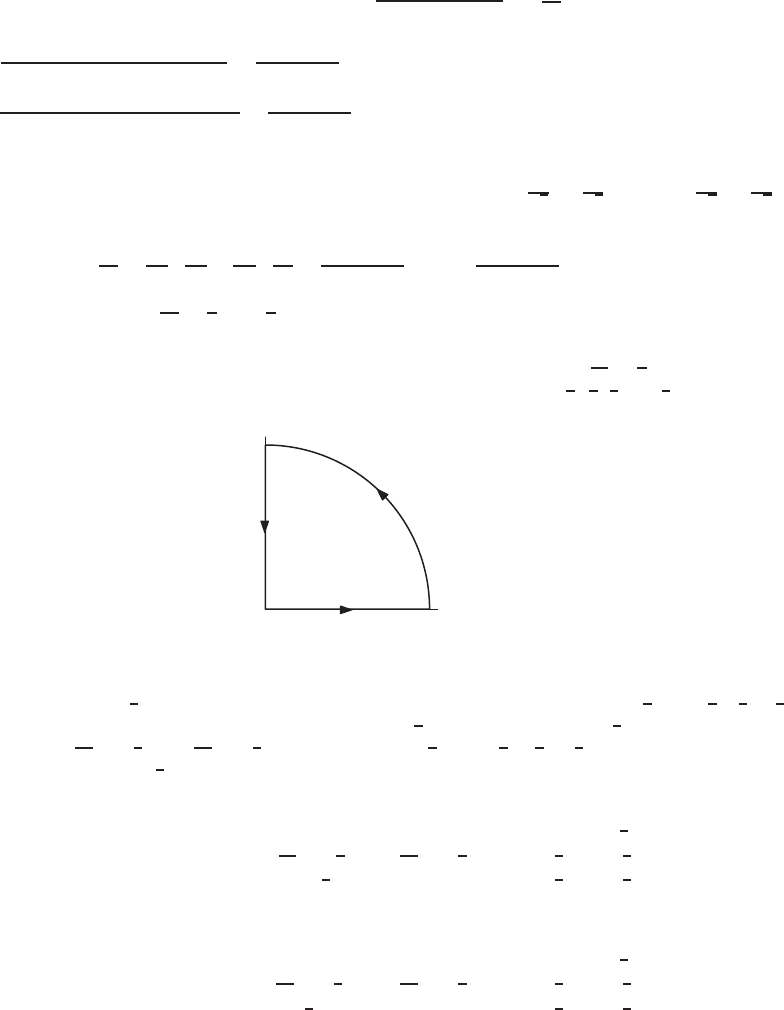
SOLUTIONS to Review Problems for Chapter Seventeen 1637
(b) The particle hits the ground when z(t) = 0, so
15 −t2+ 2t= 0
−(t−5)(t+ 3) = 0
t=−3,5.
Since t≥0, the particle hits the ground when t= 5. At that time
Position = (x(5), y(5), z(5)) = (25,15,0)
Velocity =x′(5)
~
i+y′(5)~
j+z′(5)~
k= 5
~
i+ 3~
j−8~
k
so
Speed =kVelocityk=p52+ 32+ (−8)2=√98.
45. (a) fx=2x(x2+y2)−2x(x2−y2)
(x2+y2)2=4xy2
(x2+y2)2.
fy=−2y(x2+y2)−2y(x2−y2)
(x2+y2)2=−4yx2
(x2+y2)2.
∇f(1,1) = ~
i−~
j, i.e., south-east.
(b) We need a vector ~u such that ∇f(1,1) ·~u = 0, i.e., such that (
~
i−~
j)·~u = 0. The vector ~u =~
i+~
jclearly works;
so does ~u =−~
i−~
j. Dividing by the length to get a unit vector, we have ~u =1
√2~
i+1
√2~
jor ~u =−1
√2~
i−1
√2~
j.
(c) fis a function of xand y, which in turn are functions of t. Thus, the chain rule can be used to show how fchanged
with t.
df
dt =∂f
∂x ·dx
dt +∂f
∂y ·dy
dt =4xy2
(x2+y2)2·2e2t−4x2y
(x2+y2)2·(6t2+ 6).
At t= 0,x= 1, y = 1; so, df
dt =4
4·2−4
4·6 = −4.
46. (a) Separate the ant’s path into three parts: from (0,0) to (1,0) along the x-axis; from (1,0) to (0,1) via the circle; and
from (0,1) to (0,0) along the y-axis. (See Figure 17.62.) The lengths of the paths are 1,2π
4=π
2, and 1respectively.
Thus, the time it takes for the ant to travel the three paths are (using the formula t=d
v)1
2,1
3, and 1
2seconds.
(1,0)
(0,1)
x
y
Figure 17.62
From t= 0 to t=1
2, the ant is heading toward (1,0) so its coordinate is (2t, 0). From t=1
2to t=1
2+1
3=5
6,
the ant is veering to the left and heading toward (0,1). At t=1
2, it is at (1,0) and at t=5
6, it is at (0,1). Thus its
position is (cos[ 3π
2(t−1
2)],sin[ 3π
2(t−1
2)]). Finally, from t=5
6to t=5
6+1
2=4
3, the ant is headed home. Its
coordinates are (0,−2(t−4
3)).
In summary, the function expressing the ant’s coordinates is
(x(t), y(t)) =
(2t,0) when 0≤t≤1
2
cos( 3π
2(t−1
2)),sin( 3π
2(t−1
2))when 1
2< t ≤5
6
(0,−2(t−4
3)) when 5
6≤t≤4
3.
(b) To do the reverse path, observe that we can reverse the ant’s path by interchanging the xand ycoordinates (flipping
it with respect to the line y=x), so the function is
(x(t), y(t)) =
(0,2t)when 0≤t≤1
2
sin( 3π
2(t−1
2)),cos( 3π
2(t−1
2))when 1
2< t ≤5
6
(−2(t−4
3),0) when 5
6< t ≤4
3.

1638 Chapter Seventeen /SOLUTIONS
47. Substituting x=t, and y=t2into the temperature function gives F= 1/(t2+t4). To find the rate of change of
temperature at time t, we then take the derivative with respect to t.
Rate of change of temperature =dF
dt =−(t2+t4)−2(2t+ 4t3)
=−(2 + 4t2)
t3(1 + t2)2.
The chain rule for a function of two variables says:
dz
dt =∂z
∂x
dx
dt +∂z
∂y
dy
dt ,
where zis a function of xand yand these are both functions of t. For our case, the temperature Fat any point is a function
of xand y, and the values of xand yare specified by the parameterized curve on which the bug travels, which is given in
terms of t. Thus we may say that:
dF
dt =∂F
∂x
dx
dt +∂F
∂y
dy
dt ,
where dF/dt the rate of change of the temperature of the bug at the time t. We may rewrite this expression to get:
dF
dt =∂F
∂x~
i+∂F
∂y ~
j·dx
dt~
i+dy
dt ~
j
The first vector here is ∇F, while the second vector is the velocity vector of the bug. Thus, we have
dF
dt =∇F(x, y)·~v .
48. The velocity vector is tangent to the path. At t=−2, we have
~v = (3t2−3)
~
i+ (2t−2)~
jt=−2
=9
~
i−6~
j .
Thus, the tangent line has parametric equations where the x-value changes by 9for each unit change in time, and the
y-value changes by −6for each unit change in time. Also, the tangent line must pass through the point where the particle
is at time t=−2
(t3−3t, t2−2t)t=−2
= (−2,8).
Therefore, parametric equations for the tangent line are
x=−2 + 9(t+ 2)
y= 8 −6(t+ 2).
(Other parameterizations of the line are possible.) See Figure 17.63.
−4−2 2 4
−2
2
4
6
8
x
y
Figure 17.63
: The motion given by
x=t3−3t, y =t2−2t

SOLUTIONS to Review Problems for Chapter Seventeen 1639
49. Note that uniform circular motion is possible with the given conditions, since ~v ·~a = 0 shows that the velocity and
acceleration vectors are perpendicular.
For uniform circular motion in an orbit of radius R, we have k~a k=k~v k2/R. Thus R=k~v k2/k~a k= 52/√13
for both parts (a) and (b).
The center of the orbit is at distance Rin the direction of the acceleration vector from the point Pon the orbit. The
vector
R~a
k~a k=52
√13
2
~
i+ 3~
j
√13 = 8
~
i+ 12~
j
thus extends from the point Pto the center of the orbit.
(a) The center of the orbit is at the point (0 + 8,0 + 12) = (8,12)
(b) The center of the orbit is at the point (10 + 8,50 + 12) = (18,62)
50. The displacement from the point (1,2,3) to the point (3,5,7) is 3
~
i+ 5~
j+ 7~
k−(
~
i+ 2~
j+ 3~
k) = 2
~
i+ 3~
j+ 4~
k. So
the equation of the line is
x
~
i+y~
j+z~
k= 1
~
i+ 2~
j+ 3~
k+t(2
~
i+ 3~
j+ 4~
k)
or
x
~
i+y~
j+z~
k= (1 + 2t)
~
i+ (2 + 3t)~
j+ (3 + 4t)~
k .
The square of the distance from a point (x, y, z)on the line to the origin, denoted by D(t)is
D(t) = (x−0)2+ (y−0)2+ (z−0)2
= (1 + 2t)2+ (2 + 3t)2+ (3 + 4t)2
= 1 + 4t+ 4t2+ 4 + 12t+ 9t2+ 9 + 24t+ 16t2
= 14 + 40t+ 29t2
= 29 t2+40
29 t+14
29
= 29 t+20
29 2
−20
29 2
+14
29 .
Clearly, D(t)is minimum when t=−20/29, and
D(−20/29) = 29 −20
29 2
+14
29 =6
29 .
So the shortest distance is p6
29 =√174
29 .
51. All of the points lie on the unit circle. (You can check this since x2+y2= 1.) The problem is that there is no value of t
that gives the point x= 0,y= 1. This is because
y=t2−1
t2+ 1 = 1
has no real solution. Only when tapproaches positive or negative infinity does the point get close to (0,1). Technically, it
is not a circle.
52. (a) Since there is no horizontal acceleration, if xmeasures horizontal displacement of the center in meters
d2x
dt2= 0.
Since the initial velocity is 8m/sec, integrating gives:
dx
dt = 8,
and since x= 0 when t= 0,
x= 8t.
The vertical acceleration is due to gravity. So, if yis vertical displacement of the center in meters:
d2y
dt2=−g.

1640 Chapter Seventeen /SOLUTIONS
So dy
dt =−gt + 10,
and
y=−gt2
2+ 10t+ 1.5.
Thus, the parametric equations for the center of the baton are
x= 8t, y =−gt2
2+ 10t+ 1.5.
(b) We put a new origin at the center of the baton. Suppose (h, k)are the coordinates of the end of the baton relative to
the center. Since the radius of the circular motion is 0.2m and the angular velocity is 2(2π) = 4πradians/sec and
since x= 0.2and y= 0 when t= 0, we have
h= 0.2 cos(4πt)k= 0.2 sin(4πt).
(c) To find the coordinates of the end of the baton, we add the results from parts (a) and (b), so if xand yrepresent the
position of the end of the baton relative to the ground, we have
x= 8t+ 0.2 cos(4πt)y=−gt2
2+ 10t+ 1.5 + 0.2 sin(4πt).
(d) To sketch this, use g= 9.8meters/sec 2.
0.2 5 10 15
1.5
5
x
y
Figure 17.64
53. At time tthe particle has polar coordinates r=k~r (t)k=at and θ=ωt. At time t, the ray from the origin to the
particle is at angle ωt radians from the positive x-axis. The ray is therefore rotating at a rate of ωradians per unit time.
The parameter ωis the rate of change of the polar angle θof the particle measured in radians per unit time. The larger
ωis, the quicker the particle completes a complete revolution (a 360◦trip) around the origin. At time t, the particle is at
distance at from the origin. Thus aequals the rate of change of the particle’s distance from the origin. The larger ais, the
faster the particle moves away from the origin.
54. Suppose that the line goes through the point P= (a, b, c)and is parallel to the vector ~u . The position vector of the
moving object at time tis then given by the formula ~r (t) = a
~
i+b~
j+c~
k+f(t)~u where f(t)is a function so that
f(t)~u is the displacement vector from the point Pto the object at time t.
(a) The velocity vector is given by the derivative ~r ′(t) = f′(t)~u , which is parallel to the line because it is a multiple of
the vector ~u .
(b) The acceleration vector is given by the second derivative ~r ′′(t) = f′′(t)~u which is parallel to the line because it is
a multiple of the vector ~u .
55. (a) Since ~
F=~r
k~r k3,the magnitude of ~
Fis given by
k~
Fk=k~r k
k~r k3=1
k~r k2.
Now ~r =x
~
i+y~
j+z~
k, so the magnitude of ~r is given by
k~r k=px2+y2+z2.
Thus,
k~
Fk=1
k~r k2=1
x2+y2+z2.
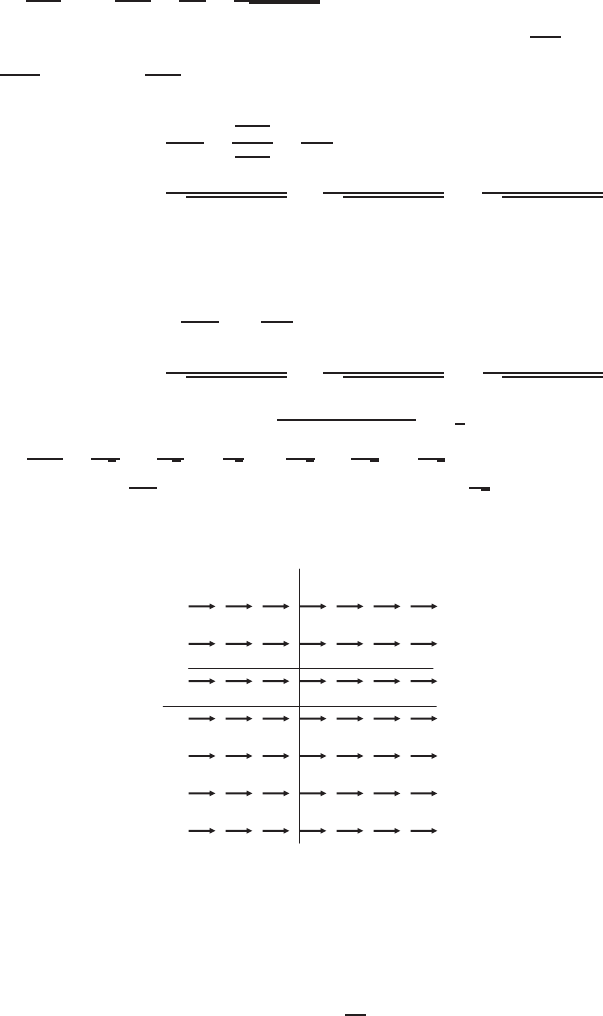
SOLUTIONS to Review Problems for Chapter Seventeen 1641
(b) ~
F·~r =~r
k~r k3·~r =k~r k2
k~r k3=1
k~r k=1
√x2+y2+z2.
(c) A unit vector parallel to ~
Fand pointing in the same direction is given by ~
U=~
F
k~
Fk.
~
F=~r
k~r k3,and k~
Fk=1
k~r k2.Putting these into the expression for ~
Uwe have
~
U=~
F
k~
Fk=
~r
k~r k3
1
k~r k2
=~r
k~r k
=x
px2+y2+z2
~
i+y
px2+y2+z2
~
j+z
px2+y2+z2
~
k .
(d) A unit vector parallel to ~
Fand pointing in the opposite direction is given by:
~
V=−~
F
k~
Fk=−~r
k~r k
=−x
px2+y2+z2
~
i+−y
px2+y2+z2
~
j+−z
px2+y2+z2
~
k .
(e) If ~r = cos t
~
i+ sin t~
j+~
k, then k~r k=pcos2t+ sin2t+ 1 = √2.
So, ~
F=~r
k~r k3=cos t
√8~
i+sin t
√8~
j+1
√8~
k=cos t
2√2~
i+sin t
2√2~
j+1
2√2~
k .
(f) We know that ~
F·~r =1
k~r k, so if ~r = cos t
~
i+ sin t~
j+~
k,~
F·~r =1
√2.
56. (a) The current, and path that the iceberg would travel, would look like Figure 17.65.
Path of iceberg
✲
Figure 17.65
To determine the location of the iceberg at time t= 7, we must first determine the velocity in the xand y
direction. In this current, Vx= 1, and Vy= 0. To obtain the position, we must integrate the velocity in terms of t.
For this current we get
dx
dt = 1
Hence
x(7) = x(0) + Z7
0
1·dt
= 1 + 7
= 8.
Since Vy=dy/dt = 0,yis a constant. Thus at t= 7,xhas moved from x= 1 to x= 8 and yhas stayed at y= 3.
Therefore the location at t= 7 is (8,3).

1642 Chapter Seventeen /SOLUTIONS
(b) The current and path that the iceberg would travel, would look like Figure 17.66.
*
■
Path of iceberg
x
y
Figure 17.66
✠
Path of iceberg
x
y
Figure 17.67
Assuming that the iceberg follows the current exactly, we find the position of the iceberg at time t= 7 by
recognizing that the velocity must be equal to the given vector field.
dx
dt = 2x
dy
dt =y
These are separable equations that are solved for xand yas follows:
dx
dt = 2x
Zdx
2x=Z1dt
ln x
2=t+C
x=kxe2t
and for y
dy
dt =y
Zdy
y=Z1dt
ln y=t+C
y=kyet
We can solve for kxand ky, the arbitrary constants, because we know the position of the iceberg at t= 0.
1 = x(0) = kx
3 = y(0) = ky
so
x=e2t, y = 3et.
We now substitute t= 7:
x=e2·7=e14 and y= 3e7
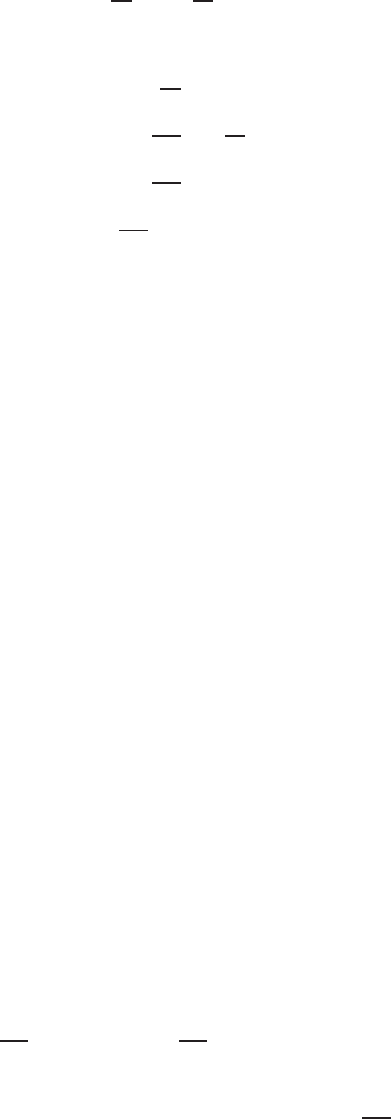
SOLUTIONS to Review Problems for Chapter Seventeen 1643
(c) The current, and path that the iceberg would travel, would look like Figure 17.67.
Since
~v =−y~
i+x~
j ,
the system of differential equations satisfied by x(t)and y(t)is
dx
dt =−y, dy
dt =x.
We differentiate one of the equations and substitute into the other, giving a second order equation
dx
dt =−y
d2x
dt2=−dy
dt
d2x
dt2=−x
d2x
dt2−x= 0
This differential equation has a solution of this form :
x=Acos t+Bsin t
By taking the derivative and using the fact that y=−dx/dt, we get:
y=Asin t−Bcos t
We know the initial position of the iceberg, so we can find the constants Aand Bwith the simultaneous equations:
1 = x(0) = Acos 0 + Bsin 0
3 = y(0) = Asin 0 −Bcos 0
Thus, A= 1 and B=−3. Now we evaluate the two expressions for t= 7:
x= cos 7 −3 sin 7 = −1.217
y= sin 7 + 3 cos 7 = 2.919
and find the position of the iceberg, (−1.217,2.919).
57. Consider the lines in the directions −−→
P Q =−9
~
i−15~
j+ 12~
kand −→
RS = 57
~
i−15~
j+ 24~
k, respectively. If the distance
between these lines is always greater than 16 then the beads can always pass without touching. If the distance is less than
16, and if that occurs at a point along the segment from Pto Qand from Rto S, then the beads will touch at that point.
Vectors in the directions of the two lines are ~u =−3
~
i−5~
j+ 4~
kand ~v = 19
~
i−5~
j+ 8~
k. Parametric equations
for the lines are:
x(t) = 7 −3t, y(t) = 12 −5t, z(t) = −10 + 4t,
and
x(s) = −20 + 19s, y(s) = 17 −5s, z(s) = 1 + 8s.
(You’ll see why we used different parameters for the two lines in a moment.)
The distance between variable points on the lines is a function of sand t; we want the minimum of this function. It
is easier to work with the square of the distance. Thus we want to find the minimum of
D(s, t) = (−27 + 19s+ 3t)2+ (5 −5s+ 5t)2+ (11 + 8s−4t)2.
Computing ∂D/∂s and ∂D/∂t and simplifying we find that
∂D
∂s = 900(−1 + s),∂D
∂t = 100(−2 + t).
The unique critical point of D(s, t)is (s, t) = (1,2) and the value of Dat that point is D(1,2) = 225. This must be the
minimum value of D(s, t), because D(s, t)is a paraboloid opening upward. (We can also check that this is the minimum
with the test for local max and local min.) The distance between the lines is therefore √225 = 15.
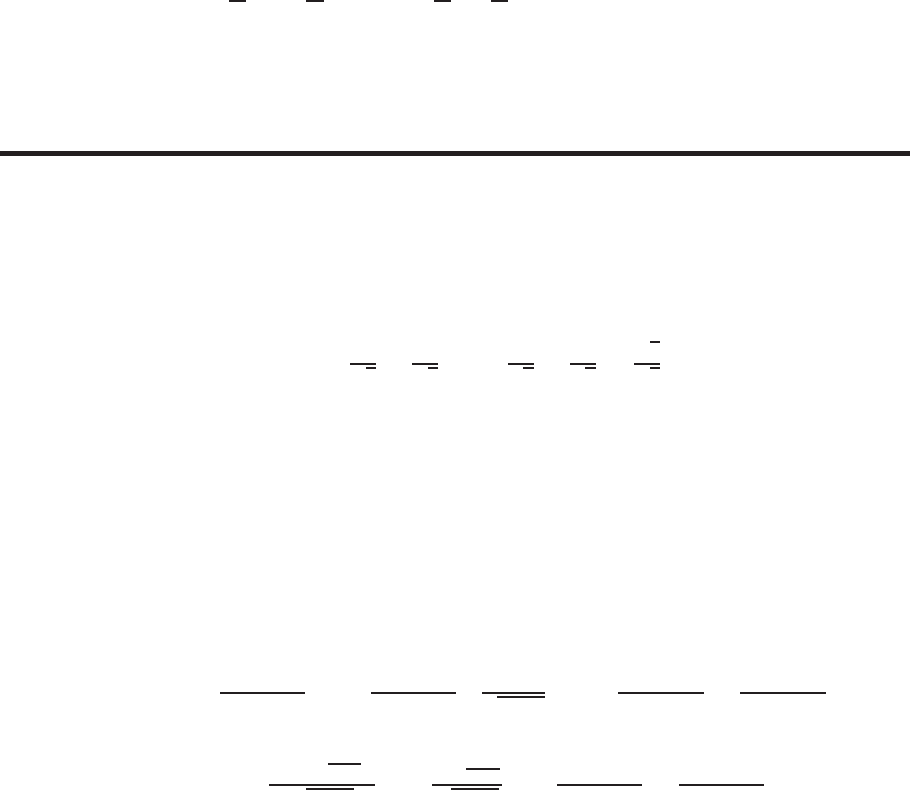
1644 Chapter Seventeen /SOLUTIONS
The points on the two lines where s= 1 and t= 2 are A= (−1,12,9) and B= (1,2,−2); these are the points
where the lines are closest. The only question now is whether Aand Bare along the segments from Rto Sand from Pto
Q. In the parameterizations of the lines, Rand Pcorrespond to s= 0 and t= 0, respectively, and Sand Qcorrespond
to to s= 3 and t= 3. So Aand Bdo lie on the given segments. If the beads are centered at these points they will hit
because they each have diameter 8 cm, whereas the lines are only 15 cm apart there.
(The solution also shows why we needed different parameters, sand t, for the two lines. The points where the lines
are closest together occur at different values of the two parameters: t= 1 for one line and s= 2 for the other.)
58. Let ~v be the velocity and let ~a be the acceleration. Since the speed v=|~v |is constant, so is v2=~v ·~v , and therefore
the derivative of v2is zero. Differentiating v2gives
0 = d
dt (v2) = d
dt (~v ·~v ) = ~v ·d
dt~v +d
dt~v ·~v =~v ·~a +~a ·~v = 2~v ·~a ,
so that
~v ·~a = 0
and therefore ~v is perpendicular to ~a .
CAS Challenge Problems
59. (a) Since ~e 1and ~e 2are perpendicular, we have ~e 1·~e 2= 0. The normal vector to the plane is~
i+~
j+~
k, and since ~e 1
and ~e 2are parallel to the plane, we have ~e 1·(
~
i+~
j+~
k) = 0 and ~e 2·(
~
i+~
j+~
k) = 0. Also, since ~e 1and ~e 2
are unit vectors, we have ~e1·~e1= 1 and ~e2·~e2= 1.
(b) We have
ac +bd = 0, a +b= 0, c +d+e= 0, a2+b2= 1, c2+d2+e2= 1
By solving these equations, we can choose, for example,
~e1=1
√2
~
i−1
√2
~
j , ~e2=1
√6
~
i+1
√6
~
j−√2
√3
~
k .
The equations of the circle will then follow from the given formula, with ~r 0=~
i+ 2~
j+ 3~
kand R= 5.
60. (a)
~r ·~
F= (x
~
i+y~
j)·(−y(1 −y2)
~
i+x(1 −y2)~
j)
=−xy(1 −y2) + yx(1 −y2) = 0
This means that the tangent line to the flow line at a point is always perpendicular to the vector from the origin to that
point. Hence the flow lines are circles centered at the origin.
(b) The circle ~r (t) = cos t
~
i+ sin t~
jhas velocity vector ~v (t) = −sin t
~
i+ cos t~
j=−y~
i+x~
j= (1 −y2)~
F. Thus
the velocity vector is a scalar multiple of ~
F, and hence parallel to ~
F. However, since ~v (t)is not equal to ~
F(~r (t)),
it is not a flow line.
(c) Using a CAS, we find
~v (t) = −t
(1 + t2)3/2~
i+−t2
(1 + t2)3/2+1
√1 + t2~
j=−t
(1 + t2)3/2~
i+1
(1 + t2)3/2~
j
and
~
F(~r (t)) = −
t1−t2
1+t2
√1 + t2
~
i+1−t2
1+t2
√1 + t2~
j=−t
(1 + t2)3/2~
i+1
(1 + t2)3/2~
j=~v (t).
Although the circle parameterized in part (b) has velocity vectors parallel to ~
Fat each point of the circle, its speed
is not equal to the magnitude of the vector field. The circle in part (c) is parameterized at the correct speed to be the
flow line.
61. (a) We have
~r ′(t) = (3ae3t−be−t)
~
i+ (6ae3t+ 2be−t)~
j
and
~
F(~r (t)) = ((ae3t+be−t) + (2ae3t−2be−t))
~
i+ ((4(ae3t+be−t) + (2ae3t−2be−t))~
j
= (3ae3t−be−t)
~
i+ (6ae3t−be−t)~
j=~r ′(t).
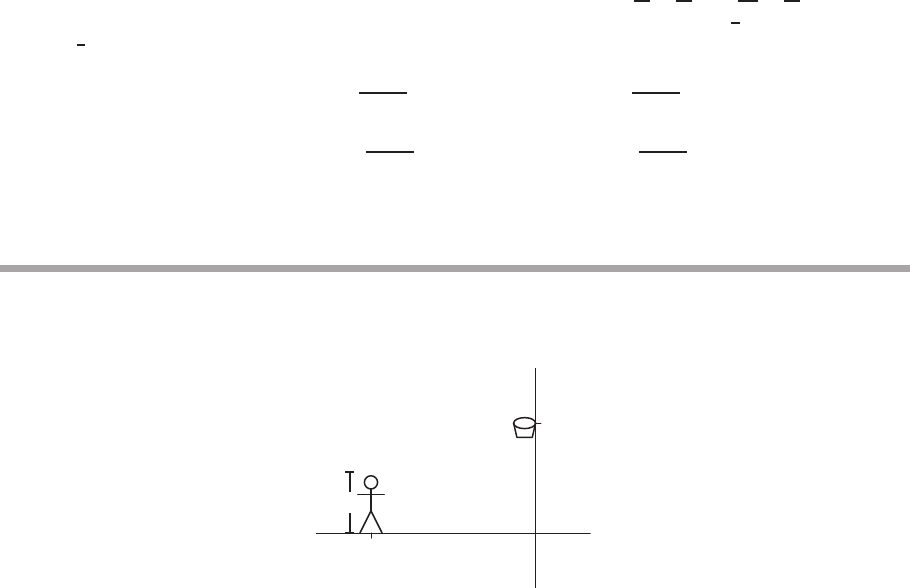
PROJECTS FOR CHAPTER SEVENTEEN 1645
(b) We want ~r (0) = ~
i−2~
j, so we solve
a+b= 1
2a−2b=−2
to get a= 0,b= 1. So the flow line is ~r (t) = e−t
~
i−2e−t~
j, which approaches (0,0) as t→ ∞. For the second
flow line, we solve
a+b= 1
2a−2b=−1.99
to get a= 0.0025, b = 0.9975, so the flow line is
~r (t) = (0.0025e3t+ 0.9975e−t)
~
i+ (0.005e3t−1.995e−t)~
j ,
which approaches (∞,∞)as t→ ∞. For the third flow line we solve
a+b= 1
2a−2b=−2.01
which gives a=−0.0025, b = 1.0025, so the flow line is
~r (t) = (−0.0025e3t+ 1.0025e−t)
~
i+ (−0.005e3t+ 2.005e−t)~
j ,
which approaches (−∞,−∞)as t→ ∞.
62. Answers may differ depending on the method and CAS used.
(a) Using a CAS to solve for xand yin terms of zand letting z=t, we get x=20
13 −6t
13 , y =−1
13 −t
13 , z =t.
(b) Using a CAS to solve for yand zin terms of xand letting x=t, we get x=t, y =1
6(−2−2t+ 3t2), z =
1
6(20 −10t−3t2).
(c) Using a CAS to solve for xand zin terms of y, we get two solutions
x=p2−t2, y =t, z = 5 + 5t−3p2−t2
and
x=−p2−t2, y =t, z = 5 + 5t+ 3p2−t2
Each of these is a parameterization of one half of the intersection curve.
PROJECTS FOR CHAPTER SEVENTEEN
1. Set up the coordinate system as shown in Figure 17.68.
(−15,0)
basket
(0,10)
✻
❄
6
player
y
x
Figure 17.68
(a) We separate the initial velocity vector into its xand ycomponents.
Vx=Vcos A
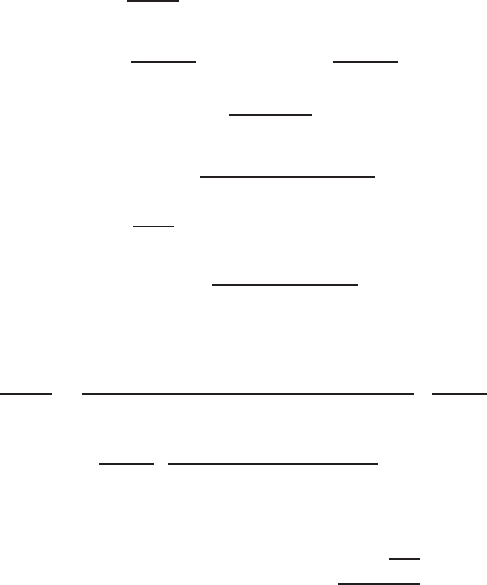
1646 Chapter Seventeen /SOLUTIONS
Vy=Vsin A.
Since there is no force acting in the xdirection, the x-coordinate of the basketball is just
x= (Vcos A)t−15.
For the y-coordinate, we know that
y′′(t)=−32,
so
y′(t)=−32t+C1
and
y(t) = −16t2+C1t+C2.
We also know that y′(0) = Vsin Aand y(0) = 6. Substituting these values in, we get C1=Vsin A,
C2= 6 and thus
y=−16t2+ (Vsin A)t+ 6.
(b) Use a graphing calculator or computer to plot the path of the basketball for various values of Vand A.
Many pairs of Vand Aput the shot in the basket. For example, V= 26, A = 60◦,V= 32, A = 30◦.
(c) Now that we have the equations, we need to find a relationship between Vand Athat ensures that the
basketball goes through the hoop (i.e., the curve passes through (0,10)). So we set
x= (Vcos A)t−15 = 0
y=−16t2+ (Vsin A)t+ 6 = 10.
From the first equation, we get t=15
Vcos A. Then we substitute that into the second equation:
−1615
Vcos A2
+ (Vsin A)( 15
Vcos A) = 4
−3600
V2cos2A+ 15 tan A= 4
V2=3600
cos2A(15 tan A−4)
Keeping in mind that tan2θ+ 1 = 1
cos2θ, we have:
V2=3600(1 + tan2A)
15 tan A−4.
We can minimize Vby minimizing V2(since V > 0).
d(V2)
dA =2 tan A(15 tan A−4) −15(tan2A+ 1)
(15 tan A−4)2·3600
cos2A= 0
3600
cos2A15 tan2A−8 tan A−15
(15 tan A−4)2= 0
15 tan2A−8 tan A−15 = 0
tan A=8 + √964
30
≈1.30
A≈52◦.
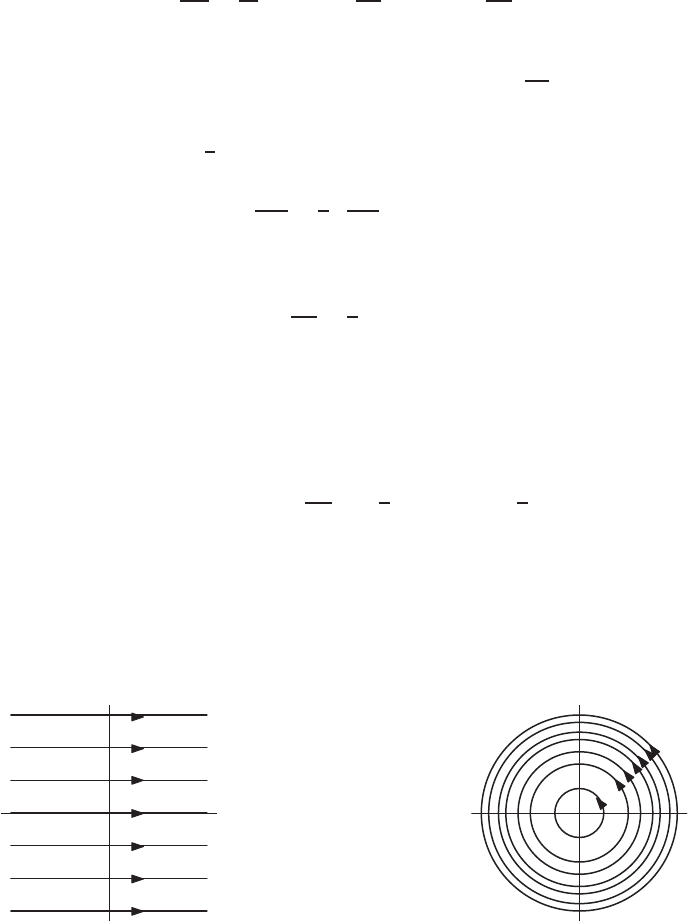
PROJECTS FOR CHAPTER SEVENTEEN 1647
2. (a) The product rule gives
d~
L
dt =d
dt(~r ×~v ) = d~r
dt ×~v +~r ×d~v
dt
=~v ×~v +~r ×~a .
But the cross product of any vector with itself is ~
0. So ~v ×~v =~
0.Hence d~
L
dt =~r ×~a .
(b) The area swept out by the planet is approximately a triangle, with sides ~r , ~r + ∆~r , and ∆~r . Since
k∆~r ×~r kis the area of the parallelogram formed by ∆~r and ~r , and since the triangle is half the size of
the parallelogram, we have ∆A≈1
2k∆~r ×~r k.
(c) Dividing by ∆tgives
∆A
∆t≈1
2
∆~r
∆t×~r
.
Taking the limit as ∆t→0and recalling that ~
L=~r ×~v , we get
dA
dt =1
2k~
Lk.
(d) Since ~a is directed from the earth to the sun, and ~r from the sun to the earth, we see that ~r and ~a are
parallel. So ~r ×~a =~
0,as the cross product of parallel vectors is ~
0.By part (a), this means d~
L /dt =~
0.
So ~
Lmust be a constant.
(e) Since k~
Lkis a constant, part (c) implies that
area swept out between
t=t0and t=t1
=Zt1
t0
dA
dt dt =1
2k~
LkZt1
t0
dt =1
2k~
Lk(t1−t0).
So the area swept out over a time interval t1−t0only depends on t1−t0, not t0and t1individually.
(f) Let’s compare the triangles of are swept out by the planet when it is closest to and furthest from the sun,
for a given size time interval. Since the ~r and ~r + ∆~r sides are shorter when the planet is closest to the
sun, the central angle and the third side must be larger then. So ∆~r , and hence ~v = ∆~r /∆t, are larger
when the planet is closest to the sun, compared to when the planet is furthest from the sun (for a fixed ∆t).
3.
x
y
(a)
Figure 17.69
x
y
(b)
Figure 17.70
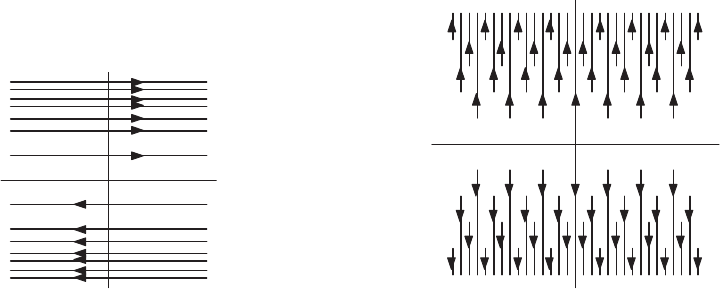
1648 Chapter Seventeen /SOLUTIONS
x
y
(c)
Figure 17.71
x
y
(d)
Figure 17.72

18.1 SOLUTIONS 1649
CHAPTER EIGHTEEN
Solutions for Section 18.1
Exercises
1. Negative because the vector field points in the opposite direction to the path.
2. Positive, because the vectors are longer on the portion of the path that goes in the same direction as the vector field.
3. Zero, because, by symmetry, the positive integral along the left half of the path cancels the negative integral along the
right half.
4. Positive, because the vector field points in the same direction as the path.
5. Zero, because the positive contributions on the upper half of the path cancel the negative contributions on the lower half
of the path.
6. Negative, because the vector field points in the opposite direction to the path.
7. Since ~
Fis perpendicular to the curve at every point along it,
ZC
~
F·d~r = 0.
8. At every point along the curve, ~
F= 2~
jand is parallel to the curve. Thus,
ZC
~
F·d~r = 2 ·Length of curve = 2 ·5 = 10.
9. Since ~
Fis perpendicular to the line, the line integral is 0.
10. Only the~
i-component contributes to the integral, so
ZC
~
F·d~r = 6 ·Length of path = 6 ·(7 −3) = 24.
11. Since ~
Fis a constant vector field and the curve is a line, RC~
F·d~r =~
F·∆~r , where ∆~r = 7~
j. Therefore,
ZC
~
F·d~r = (3
~
i+ 4~
j)·7~
j= 28
12. At every point, the vector field is parallel to segments ∆~r = ∆x
~
iof the curve. Thus,
ZC
~
F·d~r =Z6
2
x
~
i·dx
~
i=Z6
2
xdx =x2
2
6
2
= 16.
13. The ~
j-component of ~
Fdoes not contribute to the line integral. Since ∆~r = ∆x
~
i, we have
ZC
~
F·d~r =Z6
2
(x
~
i+y~
j)·dx
~
i=Z6
2
xdx =x2
2
6
2
= 16.
14. At every point on the path, ~
Fis parallel to ∆~r . Suppose ris the distance from the point (x, y)to the origin, so k~r k=r.
Then ~
F·∆~r =k~
Fkk∆~r k=r∆r. At the start of the path, r=√22+ 22= 2√2and at the end r= 6√2.Thus,
ZC
~
F·d~r =Z6√2
2√2
rdr =r2
2
6√2
2√2
= 32.

1650 Chapter Eighteen /SOLUTIONS
15. The path is along the y-axis, so only the ~
j-component contributes to the line integral. Since Cis oriented in the −~
j
direction, we have ZC
(x
~
i+6~
j−~
k)·d~r =−6·Length of path =−6·8 = −48.
16. Only the~
i-component of the vector field contributes to the integral. This component, 5
~
i, points in the opposite direction
to the orientation of the path, which has length 8. Thus,
ZC
(5
~
i+ 7~
j)·d~r =−5·Length of path =−5·8 = −40.
17. Only the~
i-component contributes to the integral, so
ZC
~
F·d~r =Z3
2
x2
~
i·~
i dx =Z3
2
x2dx =x3
3
3
2
=19
3.
18. Only the ~
jcomponent contributes to the integral. On the y-axis, x= 0, so
ZC
~
F·d~r =Z5
3
y2~
j·~
j dy =y3
3
5
3
=98
3.
19. Since the curve is along the y-axis, only the ~
jcomponent of the vector field contributes to the integral:
ZC
(2~
j+ 3~
k)·d~r =ZC
2~
j·d~r = 2 ·Length of C= 2 ·10 = 20.
20. The path is parallel to the z-axis, so the vector field is perpendicular to the path at every point. Thus, the line integral is 0.
21. Only the~
i-component contributes to the line integral, so d~r =~
i dx. On Cwe have y= 0, so
ZC
((2y+ 7)
~
i+ 3x~
j)·d~r =Z(5,0,0)
(1,0,0)
(7
~
i+ 3x~
j)·~
i dx =Z5
1
7dx = 7 ·4 = 28.
22. The vector field x
~
i+y~
j+z~
kpoints radially outward and is everywhere perpendicular to the unit circle. Thus, the line
integral is 0.
Problems
23. The line integral along C1is positive; the line integrals along C2and C3appear to be zero.
24. The line integral along C1appears to be zero, the line integral along C2is positive, and the line integral along C3is
negative.
25. The line integral along C1is negative, the line integral along C2is negative, and the line integral along C3appears to be
zero.
26. The line integral along C1appears to be 0, the line integral along C2is negative, and the line integral along C3is positive.
27. Since it appears that C1is everywhere perpendicular to the vector field, all of the dot products in the line integral are zero,
hence RC1
~
F·d~r ≈0. Along the path C2the dot products of ~
Fwith ∆~riare all positive, so their sum is positive and
we have RC1
~
F·d~r < RC2
~
F·d~r . For C3the vectors ∆~riare in the opposite direction to the vectors of ~
F, so the dot
products ~
F·∆~riare all negative; so, RC3
~
F·d~r < 0. Thus, we have
ZC3
~
F·d~r < ZC1
~
F·d~r < ZC2
~
F·d~r
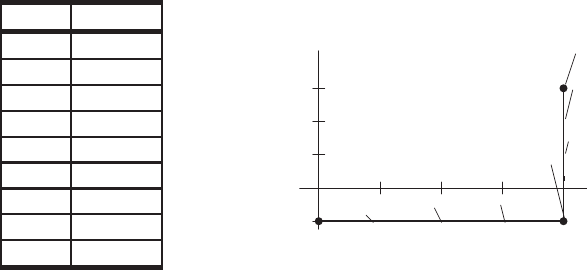
18.1 SOLUTIONS 1651
28. The integral RC~
F·d~r is a sum of the line integrals of ~
Fover each of its three straight segments, which we can compute
separately:
ZP Q
~
F·d~r =~
P Q ·~
F= (4
~
i+ 2~
j)·~
i= 4
ZQR
~
F·d~r =~
QR ·~
F= (−~
i+ 2~
j)·(2
~
i−~
j) = −4
ZRS
~
F·d~r =~
RS ·~
F= (−2
~
i−2~
j)·(3
~
i+~
j) = −8
ZC
~
F·d~r = 4 −4−8 = −8.
29. (a) See Table 18.1.
Table 18.1
(x, y)~
F(x, y)
(0,−1) −~
i
(1,−1) −~
i+~
j
(2,−1) −~
i+ 4~
j
(3,−1) −~
i+ 9~
j
(4,−1) −~
i+ 16~
j
(4,0) 16~
j
(4,1) ~
i+ 16~
j
(4,2) 2
~
i+ 16~
j
(4,3) 3
~
i+ 16~
j
123 x
−1
1
2
3
y
■❑❖
❖✻
✗
✗
✍
Figure 18.1
(b) See Figure 18.1.
(c) From the point (0,−1) to the point (4,−1), the x-component of the force field is always −1, i.e., it is pushing the
object backward with a constant force of 1. Thus, the work done on that part of the path is −1·4 = −4, because
only the horizontal component of the force field contributes to work.
From the point (4,−1) to the point (4,3), the y-component of the force field is always 16, so it is pushing the
object forward with force of 16. Thus, the work done on that part of the path is 16 ·4 = 64, because only the vertical
component of the force field contributes to work.
So the total work done is −4 + 64 = 60.
30. The force has no horizontal component. Therefore the (positive) work done in the first half of C1will be exactly canceled
by the (negative) work done in the second half, so the total work over the path C1is zero. The same holds true for C2,
again by virtue of the vertical symmetry of the path and the fact that ~
Fis constant and because the horizontal part of C2
contributes zero work. For C3, the total work will be greater than zero, since the diagonal part of C3is in the same general
direction as ~
Fand the horizontal part of C3contributes zero work.
31. The dot product of ~
Fand 10
~
iis positive if a > 0. There are no restrictions on band c.
32. The ~
kcomponent of ~
Fdoes not contribute to the line integral. Since the line integral of y~
iaround Cis negative, for the
line integral of ~
Fto be positive, we need a < 0. No restriction on cis needed.
33. The vector field ~
Fis in the same direction as Cif b > 0, so we want b < 0. No restriction is needed on c.
34. For any value of a, the vector field ay~
i−ax~
jis perpendicular to the vector ~
i+~
j+~
kwhich is in the direction of C.
Thus acan take any value. The ~
kcomponent of ~
Fis in the direction of Cif the coefficient of ~
kis positive, that is, if
c > 1.
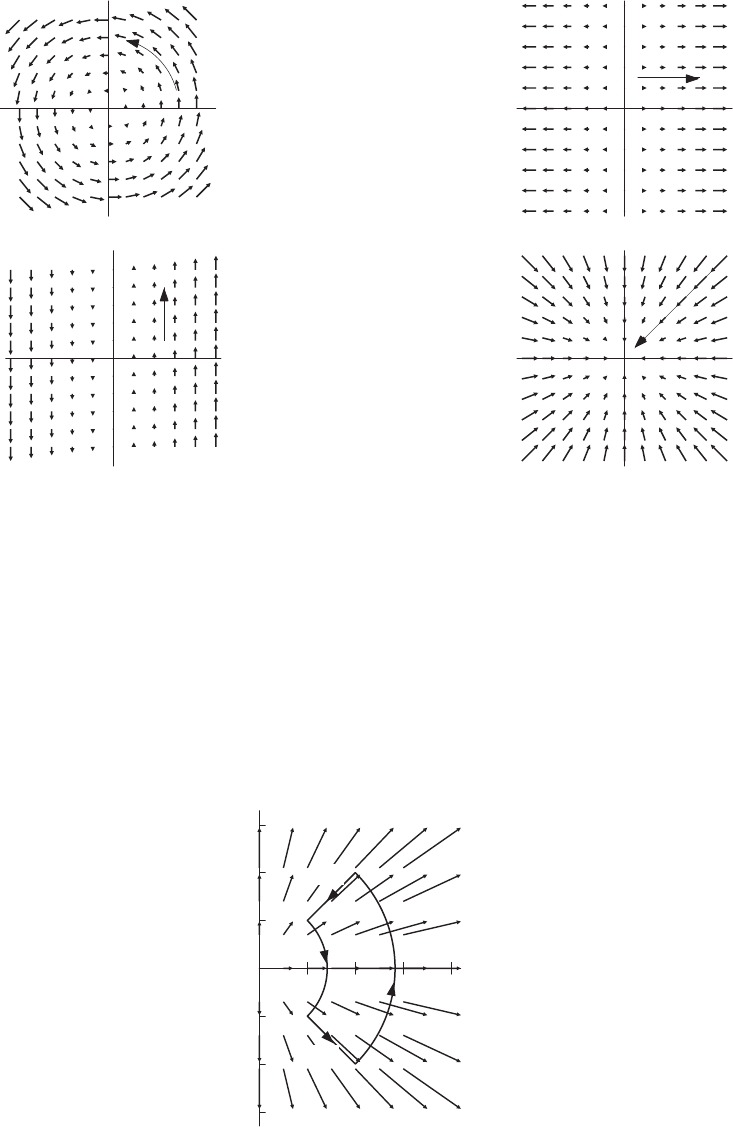
1652 Chapter Eighteen /SOLUTIONS
35. The line Cis parallel to the z-axis, so a
~
i+b~
jdoes not contribute to the line integral. Thus, there are no restrictions on
aand b. The dot product of ~
Fand −~
kis negative if c > 3.
36. (a) See Figure 18.2.
x
y
(i)
x
y
(ii)
x
y
(iii)
x
y
(iv)
Figure 18.2
(b) For (i) and (iii) a closed curve can be drawn; not for the others.
37. The vector field is F(~r ) = ~r . See Figure 18.3. The vector field is perpendicular to the circular arcs at every point, so
ZC1
~
F·d~r =ZC3
~
F·d~r = 0.
Also, since it is radially symmetric, ZC2
~
F·d~r =−ZC4
~
F·d~r .
So, ZC
=ZC1
+ZC2
+ZC3
+ZC4
= 0.
1 2 3 4
−3
−2
−1
1
2
x
y
C4
C2
C3
C1
Figure 18.3

18.1 SOLUTIONS 1653
38. This vector field is illustrated in Figure 18.4. It is perpendicular to C2and C4at every point, since ~
F(x, y)·~r (x, y) = 0
and C2and C4are radial line segments, then
ZC2
~
F·d~r =ZC4
~
F·d~r = 0.
Since C3is longer than C1, and the vector field is larger in magnitude along C3, the line integral along C3has greater
absolute value than that along C1. The line integral along C3is positive and the line integral along C1is negative, so
ZC
~
F·d~r =ZC3
~
F·d~r +ZC1
~
F·d~r > 0.
See Figure 18.4.
1 2 3
−2
−1
1
2
x
y
C4
C2
C3
C1
Figure 18.4
39. This vector field is illustrated in Figure 18.5. It is perpendicular to C2and C4at every point, since ~
F(x, y)·~r (x, y) = 0
and C2and C4are radial line segments, then
ZC2
~
F·d~r =ZC4
~
F·d~r = 0.
Since C3is longer than C1, and the vector field is larger in magnitude along C3, the line integral along C3has greater
absolute value than that along C1. The line integral along C1is positive and the line integral along C3is negative, so
ZC
~
F·d~r =ZC3
~
F·d~r +ZC1
~
F·d~r < 0.
See Figure 18.5.
1 2 3
−2
−1
1
2
x
y
C4
C2
C3
C1
Figure 18.5
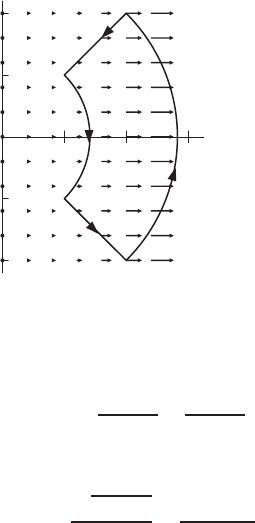
1654 Chapter Eighteen /SOLUTIONS
40. Since it does not depend on y, this vector field is constant along vertical lines, x=constant. Now let us consider two
points Pand Qon C1which lie on the same vertical line. Because C1is symmetric with respect to the x-axis, the tangent
vectors at Pand Qwill be symmetric with respect to the vertical axis so their sum is a vertical vector. But ~
Fhas only
horizontal component and thus ~
F·(∆~r (P) + ∆~r (Q)) = 0. As ~
Fis constant along vertical lines (so ~
F(P) = ~
F(Q)),
we obtain ~
F(P)·∆~r (P) + ~
F(Q)·∆~r (Q) = 0.
Summing these products and making k∆~r k → 0gives us
ZC1
~
F·d~r = 0.
The same thing happens on C3, so RC3
~
F·d~r = 0.
Now let Pbe on C2and Qon C4lying on the same vertical line. The respective tangent vectors are symmetric with
respect to the vertical axis hence they add up to a vertical vector and a similar argument as before gives
~
F(P)·∆~r (P) + ~
F(Q)·∆~r (Q) = 0
and ZC2
~
F·d~r +ZC4
~
F·d~r = 0
and so ZC
~
F·d~r = 0.
See Figure 18.6.
1 2 3
−2
−1
1
2
x
y
C4
C2
C3
C1
Figure 18.6
41. First of all, ~
F(x, y)is perpendicular to the position vector ~r (x, y) = x
~
i+y~
jbecause
~
F(x, y)·~r (x, y) = −xy
x2+y2+xy
x2+y2= 0.
Also the magnitude of ~
Fis inversely proportional to the distance from the origin because
k~
F(x, y)k=px2+y2
x2+y2=1
k~r (x, y)k.
So ~
Fis perpendicular to C2and C4and therefore
ZC2
~
F·d~r =ZC4
~
F·d~r = 0.

18.1 SOLUTIONS 1655
Suppose Ris the radius of C3. On C3, the vector field ~
Fhas the same direction as the tangent vector which is approxi-
mated by ∆~r , so we have
~
F·∆~r =k~
Fk · k∆~r k=1
Rk∆~r k.
When all these products are summed and the limit is taken as k∆~r k → 0, we get
ZC3
~
F·d~r =1
RZC3kd~r k
=1
R(length of C3) = measure of the arc C3in radians.
Similarly, suppose ris the radius of C1. On C1, the vector field ~
Fis in the opposite direction to the tangent vector
which is approximated by ∆~r . Hence we have
ZC1
~
F·d~r =−1
rZC1kd~r k
=−(1
r(length of C1)) = −(measure of C1in radians).
Since C1and C3have the same measure in radians, we have
ZC
~
F·d~r =ZC1
~
F·d~r +ZC2
~
F·d~r +ZC3
~
F·d~r +ZC4
~
F·d~r
=−π
2+ 0 + (+ π
2) + 0 = 0.
See Figure 18.7.
1 2 3
−2
−1
1
2
x
y
C4
C2
C3
C1
Figure 18.7
42. Figure 18.8 shows the wind velocity vectors on each side of the square, where the speed is vmeter/sec on the south side
and (v−12) meter/sec on the north side. The circulation is the sum of the line integrals along the four sides of the square.
The line integrals along the eastern and western edges are both zero, since the wind velocity is perpendicular to these
edges. The integral to the right along the south side equals (1000 km)(−vmeter/sec) = −v×106meter2/sec, and the
integral to the left along the north side equals (1000 km)((v−12) meter/sec) = (v−12) ×106meter2/sec.
Total circulation =−v×106+ (v−12) ×106=−1.2×107meter2/sec.
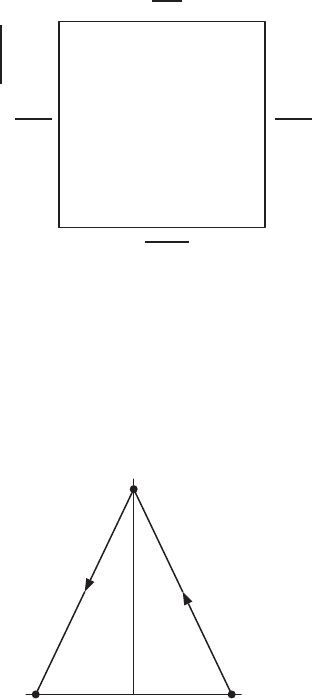
1656 Chapter Eighteen /SOLUTIONS
✻
N
✛
✛
✛
✛
1000
km
1000
km
(v−12)
meter/sec
v
meter/sec
Figure 18.8
: Wind velocity across a
square
43. Yes, the line integral over C1is the negative of the line integral over C2. One way to see this is to observe that the vector
field x
~
i+y~
jis symmetric in the y-axis and that C1and C2are reflections in the yaxis (except for orientation). See
Figure 18.9. Since the orientation of C2is the reverse of the orientation of a mirror image of C1, the two line integrals are
opposite in sign.
(1,0)(−1,0)
(0,2)
C2C1
x
y
Figure 18.9
44. Since ||~
F|| ≤ 7, the line integral cannot be larger than 7 times the length of the curve. Thus
ZC
~
F·d~r ≤7·Circumference of circle = 7 ·2π= 14π.
The line integral is equal to 14πif ~
Fis everywhere of magnitude 7, tangent to the curve, and pointing in the direction in
which the curve is traversed.
The smallest possible value occurs if the vector field is everywhere of magnitude 7, tangent to the curve and pointing
opposite to the direction in which the curve is transversed. Thus
ZC
~
F·d~r ≥ −14π.
45. The line integral is defined by chopping the curve Cinto little pieces, Ci, and forming the sum
X
Ci
~
F·∆~r .
When the pieces are small, ∆~r is approximately tangent to Ci, and its magnitude is approximately equal to the length of
the little piece of curve Ci. This means that ~
Fand ∆~r are almost parallel, the dot product is approximately equal to the
product of their magnitudes, i.e., ~
F·∆~r ≈m·(Length of Ci).

18.1 SOLUTIONS 1657
When we sum all the dot products, we get
X
Ci
~
F·∆~r ≈X
Ci
m·(Length of Ci)
=m·X
Ci
(Length of Ci)
=m·(Length of C)
46. Suppose RC~
F·d~r = 0 for every closed curve C. Pick any two fixed points P1, P2and curves C1, C2each going from
P1to P2. See Figure 18.10. Define −C2to be the same curve as C2except in the opposite direction. Therefore, the
curve formed by traversing C1, followed by C2in the opposite direction, written as C1−C2, is a closed curve, so by our
assumption, RC1−C2
~
F·d~r = 0.However, we can write
ZC1−C2
~
F·d~r =ZC1
~
F·d~r −ZC2
~
F·d~r
since C2and −C2are the same except for direction. Therefore,
ZC1
~
F·d~r −ZC2
~
F·d~r = 0,
so ZC1
~
F·d~r =ZC2
~
F·d~r .
Since C1and C2are any two curves with the endpoints P1, P2, this gives the desired result – namely, that fixing endpoints
and direction uniquely determines the value of RC~
F·d~r . In other words, the value of the integral RC~
F·d~r does not
depend on the path taken. We say the line integral is path-independent.
P1
P2
C2
C1
Figure 18.10
47. Pick any closed curve C. Choose two distinct points P1, P2on C. Let C1, C2be the two curves from P1to P2along C.
See Figure 18.11. Let −C2be the same as C2, except in the opposite direction. Thus, C1−C2=C. Therefore,
ZC
~
F·d~r =ZC1−C2
~
F·d~r =ZC1
~
F·d~r −ZC2
~
F·d~r
since C2and −C2differ only in direction. But C1and C2have the same endpoints (P1and P2)and same direction (P1
to P2), so by assumption we have RC1
~
F·d~r =RC2
~
F·d~r . Therefore,
ZC
~
F·d~r =ZC1
~
F·d~r −ZC2
~
F·d~r = 0.
P1
P2
C2
C1
Figure 18.11
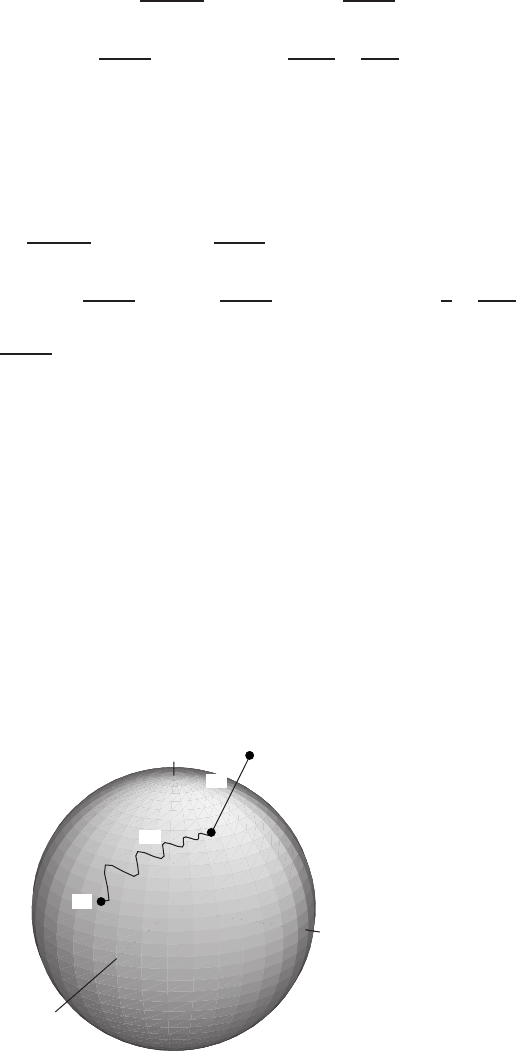
1658 Chapter Eighteen /SOLUTIONS
48. Let r=k~r k. Since ∆~r points outward, in the opposite direction to ~
F, we expect the answer to be negative.
ZC
~
F·d~r =ZC−GMm~r
r3·d~r =Z10000
8000 −GMm
r2dr
=GMm
r
10000
8000
=GMm 1
10000 −1
8000
=−2.5·10−5GMm.
49. Let r=k~r k. Since ∆~r points outward, in the opposite direction to ~
F, we expect a negative answer. We take the upper
limit to be r=∞, so the integral is improper.
ZC
~
F·d~r =ZC−GMm~r
r3·d~r =Z∞
8000 −GMm
r2dr
= lim
b→∞ Zb
8000 −GMm
r2dr = lim
b→∞
GMm
r
b
8000
= lim
b→∞ GMm 1
b−1
8000
=−GMm
8000
50. The force of the field on the particle at each point is ~
E, so the force applied in moving the particle against the field is
−~
E, so
φ(P) = −ZC
~
E·d~r
where Cis a path from P0to P.
51. Any point Pwhich is aunits from the origin can be reached from P0by a path Clying on the sphere of radius a. Since ~
E
is perpendicular to the sphere, RC~
E·d~r = 0, so φ(P) = 0. On the other hand, if Pdoes not lie on the sphere of radius a,
it can be reached by a path consisting of two pieces, C1and C2, one lying on the sphere of radius aand one going straight
along a line radiating from the origin (see Figure 18.12). RC1
~
E·d~r = 0 as before, but RC2
~
E·d~r 6= 0, since ~
Eis parallel
to C2and always points out. Thus, if Cis the path consisting of C1followed by C2, we have RC~
E·d~r =RC2
~
E·d~r .
Thus RC~
E·d~r is always positive or always negative along the path Cwhich joins P0to P. Hence the set of points with
potential zero is the sphere of radius a.
P
P0
C1
C2
x
y
z
Figure 18.12
52. In Problem 51 we saw that the surface where the potential is zero is a sphere of radius a. Let Sbe any sphere centered at
the origin, and let P1be a point on S, and C1a path from P0to P1. If Pis any point on S, then Pcan be reached from
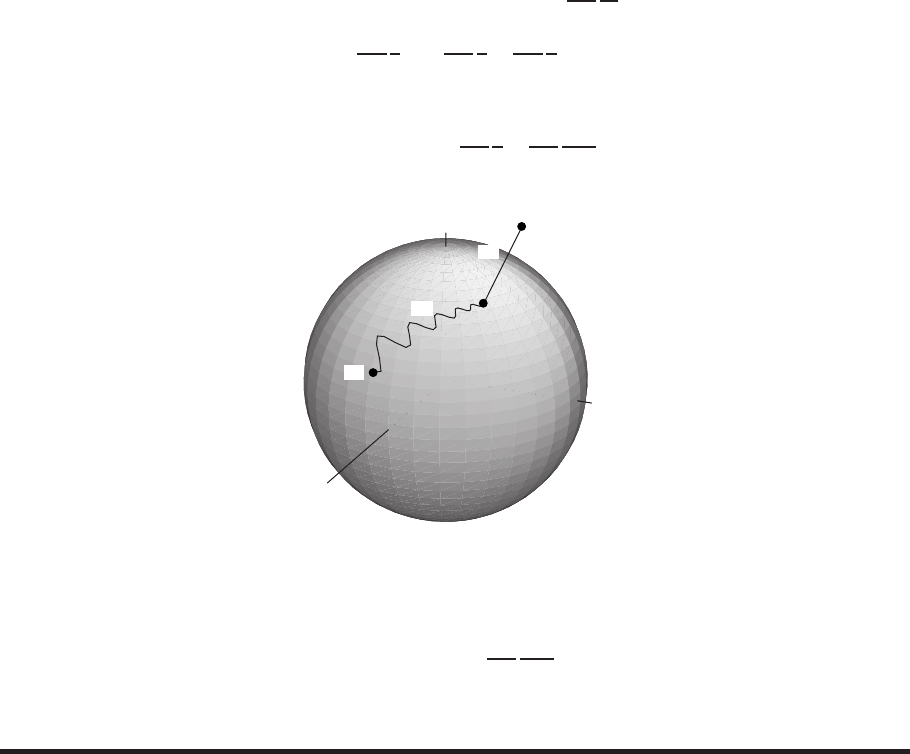
18.1 SOLUTIONS 1659
P0by a path, C, consisting of C1followed by C2, where C2is a path from P1to Plying entirely on the sphere, S. Then
RC2
~
E·d~r = 0, since ~
Eis perpendicular to the sphere. So
φ(P) = −ZC
~
E·d~r =−ZC1
~
E·d~r −ZC2
~
E·d~r =−ZC1
~
E·d~r =φ(P1).
Thus, φis constant on S. The equipotential surfaces are spheres centered at the origin.
53. (a) Suppose Pis bunits from the origin. Then Pcan be reached by a path, C, consisting of two pieces, C1and C2, one
lying on the sphere of radius aand one going straight along a line radiating from the origin (see Figure 18.13). We
have ~
E·∆~r = 0 on C1, and, writing r=k~r k, we have ~
E·∆~r =||~
E||∆ron C2, so
φ(P) = −ZC
~
E·d~r =−ZC1
~
E·d~r −ZC2
~
E·d~r
= 0 −Zb
a||~
E||dr = 0 −Zb
a
Q
4πǫ
1
r2dr
=Q
4πǫ
1
r
b
a
=Q
4πǫ
1
b−Q
4πǫ
1
a.
Let Pbe the point with position vector ~r . Then
φ(~r ) = −Q
4πǫ
1
a+Q
4πǫ
1
||~r ||.
P
P0
C1
C2
x
y
z
Figure 18.13
(b) If we let a→ ∞ in the formula for φ, the first term goes to zero and we get the simpler expression
φ(~r ) = Q
4πǫ
1
||~r ||.
Strengthen Your Understanding
54. This is only true if RC~
F·d~r > 0. However, if RC~
F·d~r < 0, then R−C~
F·d~r > 0.
55. The value of a line integral is a scalar, not a vector.
56. The curve Cis parallel at every point to the vector ~
i+~
j. The vector field ~
F=~
i−~
jis perpendicular to C, because
~
F·~
i+~
j= 0.We have RC~
F·d~r = 0 because the vector field and the curve are orthogonal at every point.
57. Choose for C1a curve going in the direction of the vectors in the vector field, and choose for C2a curve going in the
opposite direction of the vectors in the vector field. See Figure 18.14. A second option for C2consists of using C1oriented
in the downward direction.
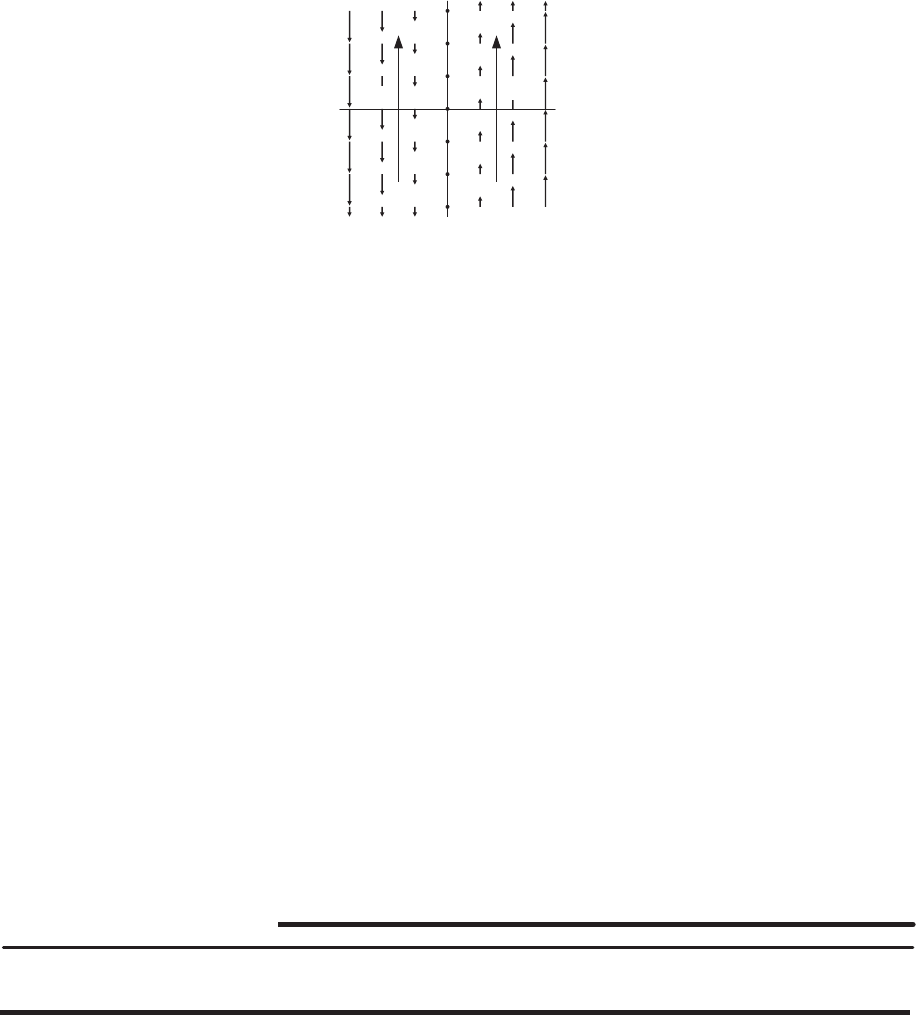
1660 Chapter Eighteen /SOLUTIONS
C2C1x
y
Figure 18.14
58. False. Because ~
F·∆~r is a scalar quantity, RC~
F·d~r is also a scalar quantity.
59. True. You can trace out C2using the same subdivisions, but each ∆~r will have the opposite sign as before and will be
traced out twice, so RC2
~
F·d~r =−2RC1
~
F·d~r =−6.
60. True. The vector field ~
F=x
~
i+y~
j=~r has radial direction, pointing everywhere perpendicular to the path of
integration, so the line integral is zero.
61. True. The line integral is the limit of a sum of dot products, hence is a scalar.
62. False. The relative sizes of the line integrals along C1and C2depend on the behavior of the vector field ~
Falong the
curves. As a counterexample, take the vector field ~
F=~
i, and C1to be the line from the origin to (0,2), while C2is
the line from the origin to (1,0). Then the length of C1is 2, which is greater than the length of C2, which is 1. However
RC1
~
F·d~r = 0 (since ~
Fis perpendicular to C1) while RC2
~
F·d~r > 0(since ~
Fpoints along C2).
63. False. For example, the vector field ~
Fcould be perpendicular to Ceverywhere. For instance, let ~
F=~
jand Cbe the
curve t
~
i, for 0≤t≤1. Alternatively, ~
Fmight point along part of Cand in the opposite direction on another part of
Cand so that the sum cancels out, yielding a zero line integral. For instance, let ~
F=x
~
iand Cbe the curve t
~
i, for
−1≤t≤1.
64. True. All of the dot products ~
F(~r i)·∆~r iin this line integral are positive, since the vector field (the constant~
i) points
in the same direction as ∆~r i.
65. False. All of the dot products ~
F(~r i)·∆~r iin this line integral are zero, since the vector field (the constant ~
i) points
perpendicular to ∆~r i.
66. False. The relation between these two line integrals depends on the behavior of the vector field along each of the curves,
so there is no reason to expect one to be the negative of the other. As an example, if ~
F(x, y) = y~
i, then, by symmetry,
both line integrals are equal to the same negative number.
67. False. The vector field swirls counterclockwise about the origin, and the path is oriented clockwise, so the line integral is
negative.
Solutions for Section 18.2
Exercises
1. If we use the parameterization x= sin t, y = cos tfor 0≤t≤π, we have x′= cos t,y′=−sin t, so
ZC
~
F·d~r =Zπ
0
((cos t)
~
i+ (sin t)~
j)·((cos t)
~
i−(sin t)~
j)dt =Zπ
0
(cos2t−sin2t)dt.
Other answers are possible
2. If we use the parameterization x=t,y= 1 + t,z=tfor 0≤t≤2, we have x′= 1,y′= 1, z′= 1,so
ZC
~
F·d~r =Z2
0
(t
~
i+t2~
k)·(
~
i+~
j+~
k)dt =Z2
0
(t+t2)dt.
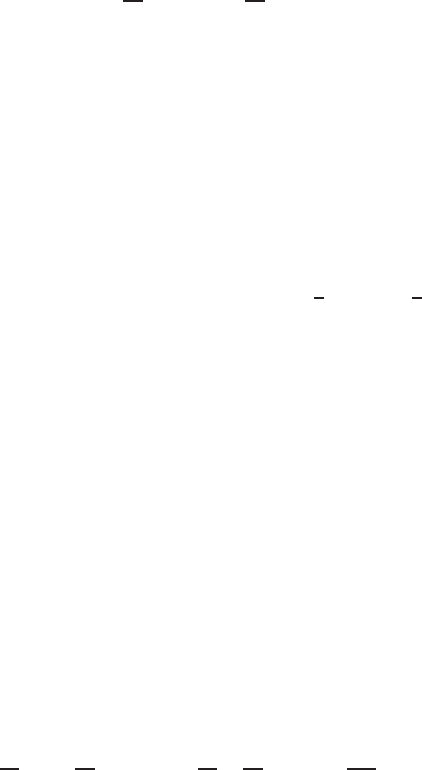
18.2 SOLUTIONS 1661
3. If we use the parameterization x= cos t, y = sin t, z = 10 for 0≤t≤2π, we have x′=−sin t,y′= cos t, z′= 0, so
ZC
~
F·d~r =Z2π
0
(cos(cos t)
~
i+ cos(sin t)~
j+ (cos 10)~
k)·(−sin t)
~
i+ (cos t)~
j)dt
=Z2π
0
(−sin tcos(cos t) + cos tcos(sin t)) dt.
4. Only the y-component of the vector field contributes to the line integral. On the curve, d~r =~
j dy, so
ZC
(3
~
i+ (y+ 5)~
j)·d~r =Z3
0
(y+ 5) dy =y2
2+ 5y
3
0
=39
2.
5. Only the~
i-component contributes to the line integral, so d~r =~
i dx and
ZC
(2x
~
i+ 3y~
j)·d~r =Z(5,0,0)
(1,0,0)
(2x
~
i+ 3y~
j)·~
i dx =Z5
1
2x dx =x2
5
1
= 24.
6. We will find the line integral from (0,0) to (3,1) and then take the negative. The line segment is parameterized by
x= 3t y =t, for 0≤t≤1.
Then ~r ′(t) = 3
~
i+~
j, so
ZC
(2y2
~
i+x~
j)·d~r =−Z1
02t2
~
i+ 3t~
j·(3
~
i+~
j)dt =−Z1
0
(6t2+ 3t)dt =−2t3+3
2t2
1
0
=−7
2.
7. The semicircle has radius 1 and is centered at (2,0). It can be parameterized by
x= 2 + cos t y = sin t, for 0≤t≤π.
Then ~r ′(t) = −sin t
~
i+ cos t~
j, so
ZC
(x
~
i+y~
j)·d~r =Zπ
0(2 + cos t)
~
i+ sin t~
j·(−sin t
~
i+ cos t~
j)dt
=Zπ
0
(−2sin t−cos tsin t+ sin tcos t)dt = 2 cos t
π
0
=−4.
8. Since ~
F= (x2+y)
~
i+y3~
j, the line integral along the third segment, which is parallel to the z-axis, is zero. On the first
segment, which is parallel to the y-axis, only the ~
j-component contributes. On the second segment, which is parallel to
the x-axis, only the~
i-component contributes. On the first segment x= 4 and yvaries from 0 to 3; on the second segment
y= 3 and xvaries from 4 to 0. Thus, we have
ZC
~
F·d~r =Z3
0
((42+y)
~
i+y3~
j)·~
j dy +Z0
4
((x2+ 3)
~
i+ 33~
j)·~
i dx
=Z3
0
y3dy +Z0
4
(x2+ 3) dx =y4
4
3
0−x3
3+ 3x
4
0
=81
4−64
3−12 = −157
12 .
9. Only the~
icomponent of ~
Fcontributes to the line integral. Since Cgoes a distance of 3 in the −~
idirection, we have
ZC
~
F·d~r = (2
~
i)·(−3
~
i) = −6.
10. Parameterizing Cby x(t) = t,y(t) = tfor 1≤t≤5, we have ~r ′(t) = ~
i+~
j,
Z~
F·d~r =Z5
1
(3~
j−~
i)·(
~
i+~
j)dt =Z5
1
2dt = 8.
1662 Chapter Eighteen /SOLUTIONS
11. The curve Cis parameterized by (x, y) = (t, t)for 0≤t≤3.Thus,
ZC
~
F·d~r =Z3
0
(t
~
i+t~
j)·(
~
i+~
j)dt=Z3
0
2tdt =t2
3
0
= 9.
12. Parameterize the curve: ~r (t) = sin t
~
i+ cos t~
j,0≤t≤π. Then
ZC
~
F·d~r =Zπ
0cos t
~
i−sin t~
j·cos t
~
i−sin t~
jdt
=Zπ
0(cos t)2+(−sin t)2dt =Zπ
0
1dt=π.
13. The line can be parameterized by (1 + 2t, 2 + 2t), for 0≤t≤1, so the integral looks like
ZC
~
F·d~r =Z1
0
~
F(1 + 2t, 2 + 2t)·(2
~
i+ 2~
j)dt
=Z1
0
[(1 + 2t)2
~
i+ (2 + 2t)2~
j]·(2
~
i+ 2~
j)dt
=Z1
0
2(1 + 4t+ 4t2) + 2(4 + 8t+ 4t2)dt
=Z1
0
(10 + 24t+ 16t2)dt
= (10t+ 12t2+ 16t3/3)1
0
= 10 + 12 + 16/3−(0 + 0 + 0) = 82/3
14. Use x(t) = t,y(t) = t2, so x′(t) = 1,y′(t) = 2t, with 0≤t≤2. Then
Z~
F·d~r =Z2
0
(−t2sin t
~
i+ cos t~
j)·(
~
i+ 2t~
j)dt
=Z2
0
(−t2sin t+ 2tcos t)dt =t2cos t2
0= 4 cos 2.
15. Parameterizing Cby x(t) = 3t, y(t) = 2tfor 0≤t≤1, we have ~r ′(t) = 3
~
i+ 2~
j, so
ZC
~
F·d~r =Z1
0
((2t)3
~
i+ (3t)2~
j)·(3
~
i+ 2~
j)dt
=Z1
0
(24t3+ 18t2)dt = 6t4+ 6t3
1
0
= 12.
16. The curve Cis parameterized by
~r = cos t
~
i+ sin t~
j , for 0≤t≤2π,
so,
~r ′(t) = −sin t
~
i+ cos t~
j .
Thus,
ZC
~
F·d~r =Z2π
0
(2 sin t
~
i−sin (sin t)~
j)·(−sin t
~
i+ cos t~
j)dt
=Z2π
0
(−2 sin2t−sin (sin t) cos t)dt
= sin tcos t−t+ cos (sin t)
2π
0
=−2π.
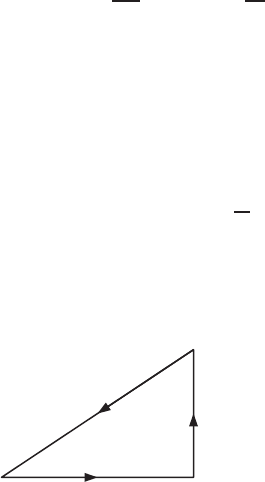
18.2 SOLUTIONS 1663
17. The parameterization is given, so
ZC
~
F·d~r =Z4
2
~
F(2t, t3)·(2
~
i+ 3t2~
j)dt
=Z4
2
[(ln(t3)
~
i+ ln(2t)~
j]·(2
~
i+ 3t2~
j)dt
=Z4
2
(2 ln(t3) + 3t2ln(2t)) dt
=Z4
2
(6 ln(t) + 3t2ln(2t)) dt since ln(t3) = 3 ln(t).
This integral can be computed numerically, or using integration by parts or the integral table, giving
ZC
~
F·d~r =Z4
2
(6 ln(t) + 3t2ln(2t)) dt
= (6(tln(t)−t) + t3ln(2t)−t3/3)4
2
= 240 ln 2 −136
3−(28 ln 2 −44
3)
= 212 ln 2 −92/3≈116.28.
The expression containing ln 2 was obtained using the properties of the natural log.
18. Parameterizing Cby x(t) = t, y(t) = t, z(t) = tfor 0≤t≤2, we have ~r ′(t) = ~
i+~
j+~
k, so
ZC
(x
~
i+6~
j−~
k)·d~r =Z2
0
(t
~
i+6~
j−~
k)·(
~
i+~
j+~
k)dt
=Z2
0
(t+6−1) dt =t2
2+ 5t
2
0
= 12.
19. The triangle Cconsists of the three paths shown in Figure 18.15.
(0,0) (3,0)
(3,2)
C1
C2
C3
Figure 18.15
Write C=C1+C2+C3where C1,C2, and C3are parameterized by
C1: (t, 0) for 0≤t≤3; C2: (3, t)for 0≤t≤2; C3: (3 −3t, 2−2t)for 0≤t≤1.
Then ZC
~
F·d~r =ZC1
~
F·d~r +ZC2
~
F·d~r +ZC3
~
F·d~r
where
ZC1
~
F·d~r =Z3
0
~
F(t, 0) ·~
i dt =Z3
0
(2t+ 4)dt = (t2+ 4t)3
0= 21

1664 Chapter Eighteen /SOLUTIONS
ZC2
~
F·d~r =Z2
0
~
F(3, t)·~
j dt =Z2
0
(5t+ 3)dt = (5t2/2 + 3t)2
0= 16
ZC3
~
F·d~r =Z1
0
~
F(3−3t, 2−2t)·(−3
~
i−2~
j)dt
=Z1
0
((−4t+ 8)
~
i+ (−19t+ 13)~
j)·(−3
~
i−2~
j)dt
= 50 Z1
0
(t−1)dt =−25.
So ZC
~
Fd~r = 21 + 16 −25 = 12.
20. Since ~r =x(t)
~
i+y(t)~
j+z(t)~
k=t
~
i+t2~
j+t3~
k, for 1≤t≤2,
we have ~r ′(t) = x′(t)
~
i+y′(t)~
j+z′(t)~
k=~
i+ 2t~
j+ 3t2~
k. Then
ZC
~
F·d~r =Z2
1
(t
~
i+ 2t3t2~
j+t~
k)·(
~
i+ 2t~
j+ 3t2~
k)dt
=Z2
1
(t+ 4t6+ 3t3)dt
=t2
2+4t7
7+3t4
4
2
1
=2389
28 ≈85.32
21. We parameterize Cby
~r = 2t
~
i+ 3t~
j+ 4t~
k , for 0≤t≤1.
Then ~r ′(t) = 2
~
i+ 3~
j+ 4~
kand so
ZC
~
F·d~r =Z1
0(2t)3
~
i+ (3t)2~
j+ (4t)~
k·(2
~
i+ 3~
j+ 4~
k)dt
=Z1
0
(16t3+ 27t2+ 16t)dt
= 4t4+ 9t3+ 8t2
1
0
=21.
22. Since Cis given by ~r = cos t
~
i+ sin t~
j+t~
k , we have ~r ′(t) = −sin t
~
i+ cos t~
j+~
k . Thus,
ZC
~
F·d~r =Z4π
0
(−sin t
~
i+ cos t~
j+ 5~
k)·(−sin t
~
i+ cos t~
j+~
k)dt
=Z4π
0
(sin2t+ cos2t+ 5)dt =Z4π
0
6dt = 24π.
23. The first step is to parameterize Cby
(x(t), y(t), z(t)) = (0,2 cos t, −2 sin t),0≤t≤2π.
Thus, we have
~r ′(t) = x′(t)
~
i+y′(t)~
j+z′(t)~
k=−2 sin t~
j−2 cos t~
k .
So we have
ZC
~
F·d~r =Z2π
0
(e2 cos t
~
i+~
k)·((−2 sin t)~
j+ (−2 cos t)~
k)dt

18.2 SOLUTIONS 1665
=Z2π
0−2 cos tdt
=−2 sin t
2π
0
= 0
24. RC3xdx −ysin xdy
25. RCy2dx+z2dy + (x2−5)dz
26. ~
F= (x+ 2y)
~
i+x2y~
j
27. ~
F=e−3y~
i−yz(sin x)~
j+ (y+z)~
k
28. From x=t2and y=t3we get dx = 2tdt and dy = 3t2dt. Hence
ZC
ydx +xdy =Z5
1
t3(2t)dt +t2(3t2)dt =Z5
1
5t4dt = 55−1 = 3124.
29. From
x= cos t, y = sin t, z = 3t
we get
dx =−sin t dt dy = cos t dt, dz = 3dt.
Hence
ZC
dx+ydy +zdz =Z2π
0−sin t dt + sin tcos t dt + 3t(3dt)
= cos t+1
2sin2t+9
2t2|2π
0= 18π2.
30. Parameterize C:
x= 1 + 4t, y = 3 + 6t, 0≤t≤1
so that dx = 4dt and dy = 6dt. Hence
ZC
3ydx + 4xdy =Z1
0
3(3 + 6t)4dt + 4(1 + 4t)6dt =Z1
0
60 + 168tdt = 144.
31. Parameterize C:
x= 0, y = 3 cos t, z = 3 sin t, 0≤t≤2π
so that
dx = 0dt, dy =−3 sin t dt, dz = 3 cos t dt.
Hence
ZC
xdx +zdy −ydz =Z2π
0
0dt+ 3 sin t(−3 sin t)dt −3 cos t(3 cos t)dt =Z2π
0−9dt =−18π.
Problems
32. (a) Since ~r (t) = t
~
i+t2~
j, we have ~r ′(t) = ~
i+ 2t~
j. Thus,
ZC
~
F·d~r =Z1
0
~
F(t, t2)·(
~
i+ 2t~
j)dt
=Z1
0
[(3t−t2)
~
i+t~
j]·(
~
i+ 2t~
j)dt
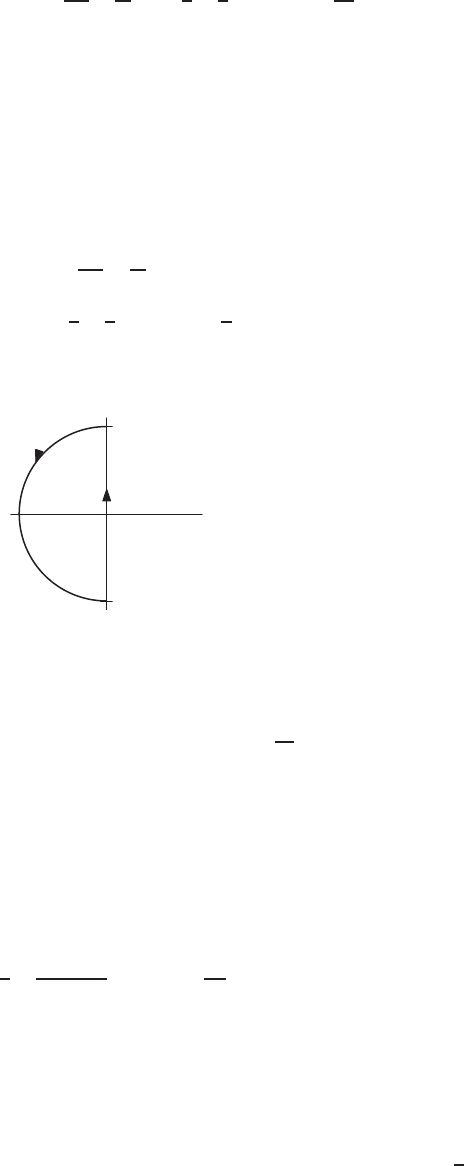
1666 Chapter Eighteen /SOLUTIONS
=Z1
0
(3t+t2)dt
= ( 3t2
2+t3
3)
1
0
=3
2+1
3−(0 + 0) = 11
6
(b) Since ~r (t) = t2
~
i+t~
j, we have ~r ′(t) = 2t
~
i+~
j. Thus,
ZC
~
F·d~r =Z1
0
~
F(t2, t)·(2t
~
i+~
j)dt
=Z1
0
[(3t2−t)
~
i+t2~
j]·(2t
~
i+~
j)dt
=Z1
0
(6t3−t2)dt
= ( 3t4
2−t3
3)
1
0
=3
2−1
3−(0 −0) = 7
6
33. (a) Figure 18.16 shows the curves.
−1
1
C2
C1
x
y
Figure 18.16
(b) On C1, only the ~
j-component of ~
Fcontributes to the integral. There d~r =~
j dy, so
ZC1
~
F·d~r =Z1
−1
y~
j·~
j dy =Z1
−1
y dy =y2
2
1
−1
= 0.
On C2, we have ~r ′(t) = −sin t
~
i+ cos t~
j, so
ZC2
~
F·d~r =Z3π/2
π/2
((cos t+ 3 sin t)
~
i+ sin t~
j)·(−sin t
~
i+ cos t~
j)dt
=Z3π/2
π/2−cos tsin t−3 sin2t+ cos tsin t dt =Z3π/2
π/2−3 sin2t dt
=−3t
2−sin tcos t
2
3π/2
π/2
=−3π
2.
34. First, check that each of these gives a parameterization of L: each has both coordinates equal (as do all points on L) and
each begins at (0,0) and ends at (1,1).Now we calculate the line integral of the vector field ~
F= (3x−y)
~
i+x~
jusing
each parameterization.
(a) Using B(t)gives
ZL
~
F·d~r =Z1/2
0
((6t−2t)
~
i+ 2t~
j)·(2
~
i+ 2~
j)dt =Z1/2
0
12t dt = 6t2
1/2
0
=3
2.
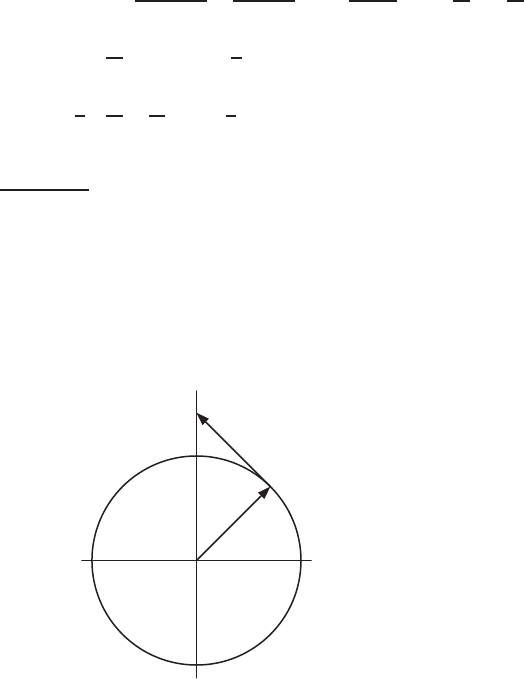
18.2 SOLUTIONS 1667
(b) Now we use C(t):
ZL
~
F·d~r =Z2
13(t2−1)
3−(t2−1)
3~
i+t2−1
3~
j·2t
3~
i+2t
3~
jdt
=Z2
1
2t
3(t2−1) dt =2
3Z2
1
(t3−t)dt
=2
3t4
4−t2
2
2
1
=3
2.
35. (a) The unit circle centered at the origin has equation x2+y2= 1. At any point in the plane, the magnitude of ~
Fis
given by k~
Fk=p(−y)2+x2. Along the unit circle, k~
Fk= 1.
(b) Suppose ~r =x
~
i+y~
jis a radius vector to a point (x, y)on the unit circle centered at the origin. See Figure 18.17.
Then
~r ·~
F= (x
~
i+y~
j)·(−y~
i+x~
j) = −xy +xy = 0.
So the vector field is perpendicular to any corresponding radius vector, that is, the vector field is tangent to the circle
at every point.
x
y
x2+y2= 1
~r
~
F=−y~
i+x~
j
Figure 18.17
(c) We can parameterize Cby (cos t, sin t), for 0≤t≤2π. Then
ZC
~
F·d~r =Z2π
0
~
F(cos t, sin t)·(−sin t
~
i+ cos t~
j)dt
=Z2π
0
(−sin t
~
i+ cos t~
j)·(−sin t
~
i+ cos t~
j)dt
=Z2π
0
(sin2t+ cos2t)dt
=Z2π
0
1dt
= 2π
Thus, ZC
~
F·d~r = 2π=Circumference of the unit circle.
36. We parameterize the helical staircase by observing that
x= 5 cos t, y = 5 sin t, z =t
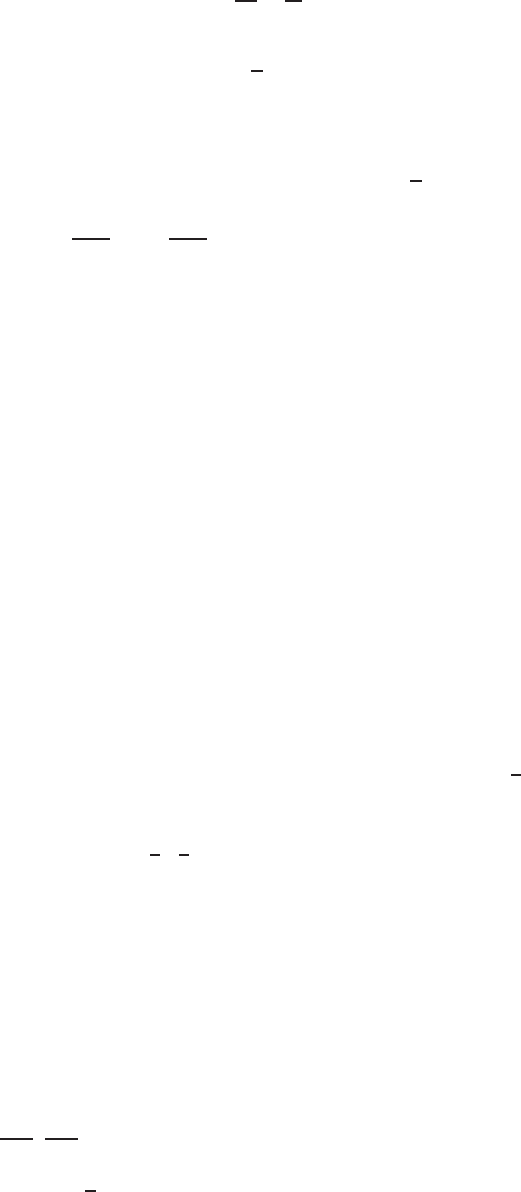
1668 Chapter Eighteen /SOLUTIONS
has the correct radius, but climbs 2πin one revolution. To make it climb 4 meters in one revolution, we write:
x= 5 cos t, y = 5 sin t, z =4t
2π=2t
π.
Thus,
~r ′(t) = −5 sin t
~
i+ 5 cos t~
j+2
π~
k .
The gravitational force is given by ~
F=−70g~
k , and we want to go around 2 turns of the staircase, so we take 0≤t≤
4π. Thus,
Work done by gravity =Z~
F·d~r =Z4π
0−70g~
k·(−5 sin t
~
i+ 5 cos t~
j+2
π~
k)dt
=Z4π
0−140g
πdt =−140g
πt
4π
0
=−560g.
Notice that the result can also be obtained by multiplying the force by the vertical distance:
Gravitational force ·Vertical distance moved = (−70g)8 = −560g.
Now
Work done by person =−Work done by gravity = 560g.
37. The original integral is along the line from (1,0,0) to (2,2,3).
(a) This integral uses the same parameterization, but starting at (2,2,3) and ending at (1,0,0).Thus, the value of the
integral is −5.
(b) This integral is along the same line segment from (1,0,0) to (2,2,3) but using the parameterization x=t2+ 1,
y= 2t3,z= 3t2. Thus, the value of the integral is the same, 5.
(c) Using the parameterization in part(b), this integral traverses the line segment twice, from (2,2,3) to (1,0,0) and
then back to (2,2,3). Since the segment is traversed once in each direction, the value of the integral is 0.
38. The integral corresponding to A(t) = (t, t)is Z1
0
3tdt.
The integral corresponding to B(t) = (2t, 2t)is Z1/2
0
12t dt.
The substitution s= 2thas ds = 2 dt and s= 0 when t= 0 and s= 1 when t= 1/2. Thus, substituting t=s
2into the
integral corresponding to B(t)gives
Z1/2
0
12t dt =Z1
0
12( s
2)( 1
2ds) = Z1
0
3s ds.
The integral on the right-hand side is now the same as the integral corresponding to A(t). Therefore we have
Z1/2
0
12t dt =Z1
0
3s ds =Z1
0
3t dt.
Alternatively, a similar calculation shows that the substitution t= 2wconverts the integral corresponding to A(t)
into the integral corresponding to B(t).
39. The integral corresponding to A(t) = (t, t)is Z1
0
3tdt.
The integral corresponding to C(t) = ( t2−1
3,t2−1
3)is
2
3Z2
1
(t3−t)dt.

18.2 SOLUTIONS 1669
The substitution s=t2−1
3has ds =2
3t dt. Also s= 0 when t= 1 and s= 1 when t= 2. Thus, substituting into the
integral corresponding to C(t)gives
2
3Z2
1
(t3−t)dt =Z2
1
(t2−1) 2
3t dt =Z1
0
3s ds.
The integral on the right-hand side is the same as the integral corresponding to A(t). Therefore we have
2
3Z2
1
(t3−t)dt=Z1
0
3s ds =Z1
0
3t dt.
Alternatively, the substitution t=w2−1
3converts the integral corresponding to A(t)into the integral corresponding
to C(t).
40. The integral corresponding to A(t) = (t, t)is Z1
0
3t dt.
The integral corresponding to D(t) = (et−1, et−1) is
3Zln 2
0
(e2t−et)dt.
The substitution s=et−1has ds =etdt. Also s= 0 when t= 0 and s= 1 when t= ln 2. Thus, substituting into the
integral corresponding to D(t)and using the fact that e2t=et·etgives
3Zln 2
0
(e2t−et)dt= 3 Zln 2
0
(et−1)etdt =Z1
0
3s ds.
The integral on the right-hand side is the same as the integral corresponding to A(t). Therefore we have
3Zln 2
0
(e2t−et)dt=Z1
0
3s ds =Z1
0
3t dt.
Alternatively, the substitution t=ew−1converts the integral corresponding to A(t)into the integral corresponding to
B(t).
41. (a) The line integral RC(xy~
i+x~
j)·d~r is positive. This follows from the fact that all of the vectors of xy~
i+x~
j
at points along Cpoint approximately in the same direction as C(meaning the angles between the vectors and the
direction of Care less than π/2).
(b) Using the parameterization x(t) = t,y(t) = 3t, with x′(t) = 1,y′(t) = 3, we have
ZC
~
F·d~r =Z4
0
~
F(t, 3t)·(
~
i+ 3~
j)dt
=Z4
0
(3t2
~
i+t~
j)·(
~
i+ 3~
j)dt
=Z4
0
(3t2+ 3t)dt
=t3+3
2t2
4
0
= 88.
(c) Figure 18.18 shows the oriented path C′, with the “turn around” points Pand Q. The particle first travels from the
origin to the point P(call this path C1), then backs up from Pto Q(call this path C2), then goes from Qto the point
(4,12) in the original direction (call this path C3). See Figure 18.19. Thus, C′=C1+C2+C3. Along the parts of
C1and C2that overlap, the line integrals cancel, so we are left with the line integral over the part of C1that does not
overlap with C2, followed by the line integral over C3. Thus, the line integral over C′is the same as the line integral
over the direct route from the point (0,0) to the point (4,12).
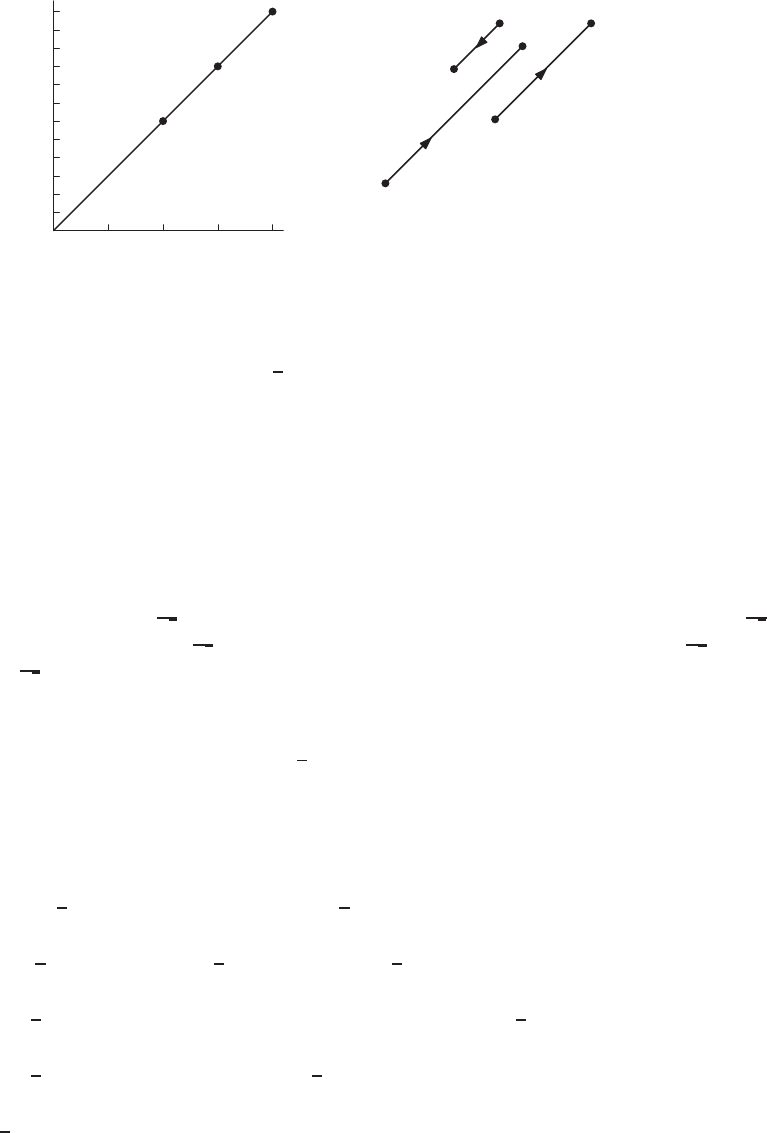
1670 Chapter Eighteen /SOLUTIONS
Q
P
(4,12)
1 2 3 4
0
1
2
3
4
5
6
7
8
9
10
11
12
x
y
Figure 18.18
C1
C2
C3
Figure 18.19
(d) The parameterization
(x(t), y(t)) = 1
3(t3−6t2+ 11t),(t3−6t2+ 11t)
has (x(0), y(0)) = (0,0) and (x(4), y(4)) = (4,12). The form of the parameterization we were given shows that
the second coordinate is always three times the first. Thus all points on the parameterized curve lie on the line y= 3x.
We have to do a bit more work to guarantee that all points on the curve lie on the line between the point (0,0)
and the point (4,12); it is possible that they might shoot off to, say, (100,300) before returning to (4,12). Let’s
investigate the maximum and minimum values of f(t) = t3−6t2+ 11ton the interval 0≤t≤4. We can do this on
a graphing calculator or computer, or use single-variable calculus. We already know the values of fat the endpoints,
namely 0and 12. We’ll look for local extrema:
0 = f′(t) = 3t2−12t+ 11
which has roots at t= 2 ±1
√3. These are the values of twhere the particle changes direction: t= 2 −1
√3
corresponds to point Pand t= 2 + 1
√3corresponds to point Qof C′. At these values of twe have f(2 −1
√3)≈6.4,
and f(2 + 1
√3)≈5.6. The fact that these values are between 0 and 12 shows that ftakes on its maximum and
minimum values at the endpoints of the interval and not in between.
(e) Using the parameterization given in part (d), we have
~r ′(t) = x′(t)
~
i+y′(t)~
j=1
3(3t2−12t+ 11)
~
i+ (3t2−12t+ 11)~
j .
Thus,
ZC′
~
F·d~r
=Z4
0
~
F(1
3(t3−6t2+ 11t), t3−6t2+ 11t)·(1
3(3t2−12t+ 11)
~
i+ (3t2−12t+ 11)~
j)dt
=Z4
0
(1
3(t3−6t2+ 11t)2
~
i+1
3(t3−6t2+ 11t)~
j)·(1
3(3t2−12t+ 11)
~
i+ (3t2−12t+ 11)~
j)dt
=Z4
0
1
3(t3−6t2+ 11t)(3t2−12t+ 11) n((t3−6t2+ 11t)
~
i+~
j)·(1
3~
i+~
j)odt
=Z4
0
1
3(t3−6t2+ 11t)(3t2−12t+ 11) n1
3(t3−6t2+ 11t) + 1odt
=1
9Z4
0
(t3−6t2+11t)(3t2−12t+ 11)(t3−6t2+ 11t+ 3) dt
Numerical integration yields an answer of 88, which agrees with the answer found in part b).

18.2 SOLUTIONS 1671
Strengthen Your Understanding
42. The substitution of the parameterization into the vector field ~
Fwas done correctly, but instead of computing d~r =
~r ′(t)dt, the second integral used ~r (t)dt. Since ~r (t) = cos t
~
i+ sin t~
j, we have ~r ′(t)dt =−sin t
~
i+ cos t~
j, so the
correct parameterized line integral is
ZC
~
F·d~r =Zπ/2
0
(cos t
~
i−sin t~
j)·(−sin t
~
i+ cos t~
j)dt.
43. The sign and value of RC3dx+ 4 dy depend on the oriented curve C. For example, if moving along Cin the direction
of its orientation increases xand y, then the integral is positive, and if it decreases xand y, then the integral is negative.
If the curve is in the direction of the vector 3
~
i+ 4~
j, then the integral is positive, but if the curve is in the opposite
direction, then the integral is negative.
44. The path is a semicircle of radius 3 centered at the origin, so a vector field that points away from the origin will be
perpendicular to the path at all points, and the integral will be zero. For example, if ~
F(x, y) = x
~
i+y~
j, then RC~
F·d~r =
0.
45. The vector field points parallel to the x-axis at every point and is constant along any horizontal line, since the magnitude
only depends on y. The parameterized path y=π/2,x=t,0≤t≤3, has length 3, and at every point on the path the
vector field points in the direction of the path and has magnitude ksin y~
ik= sin(π/2) = 1. So RC~
F·d~r = 3 ·1 = 3.
46. False. The relation between these two line integrals depends on the behavior of the vector field along each of the curves, so
there is no reason to expect one to be larger than the other. If, for example, the line integral along C2is negative, then the
line integral along both taken together (C1+C2) will be less than the line integral over C1by itself. A specific example
is given by ~
F=~
i, with C1the line from (0,0) to (1,0), and C2the line from (1,0) to (0,1). Then RC1
~
F·d~r =
R1
0~
i·~
i dt = 1/2, and RC1+C2
~
F·d~r = 1/2 + R1
0~
i·(−~
i+~
j)dt = 1/2−1 = −1/2.
47. True. The dot product of the integrand 4
~
iwith ~r ′(t) = ~
i+ 2t~
jis 4, so the integral has value R2
04dt = 8.
48. False. The curves C1and C2are different. The curve C1starts at the point (1,0) and travels around the unit circle
counterclockwise to (−1,0).The curve C2starts at the point (1,0) and travels around the unit circle clockwise to (−1,0).
49. True. The curves C1and C2both parameterize the upper unit semicircle with the same orientation (but at different speeds).
Since the line integral is independent of parameterization, the integrals over C1and C2are the same.
50. False. As a counterexample, consider the unit circle C, centered at the origin, oriented counterclockwise and the vector
field ~
F=−y~
i+x~
j. The vector field is always tangent to the circle, and in the same direction as C, so the line integral
is positive.
51. False. As a counterexample, consider the vector field ~
F=x
~
i. Then if we parameterize C1by ~r (t) = t
~
i, with 0≤t≤1,
we get ZC1
x
~
i·d~r =Z1
0
t
~
i·~
i dt =Z1
0
t dt =t2
2
1
0
=1
2.
A similar computation for C2gives a line integral with value 2.
52. True. If we parameterize Cby ~r (t) = acos t
~
i+asin t~
j, with 0≤t≤2π, then
ZC
(2x
~
i+y~
j)·d~r =Z2π
0
(2acos t
~
i+asin t~
j)·(−asin t
~
i+acos t~
j)dt =Z2π
0−a2cos tsin t dt
=a2cos2t
2
2π
0
=0.
53. False. If we parameterize Cby ~r (t) = acos t
~
i+asin t~
j, with 0≤t≤2π, then
ZC
(2y~
i+x~
j)·d~r =Z2π
0
(2asin t
~
i+acos t~
j)·(−asin t
~
i+acos t~
j)dt =Z2π
0−2a2sin2t+a2cos2tdt =−πa2.
54. True. The curves C1and C2are the same (they follow the graph of y=x2between (0,0) and (2,4)), except that their
orientations are opposite.
55. (a). The two parameterizations give the same path, but one goes in the opposite direction to the other. Since ~
Fpoints
away from the origin, and C1is oriented away from the origin, RC1
~
F·d~r is positive, so RC2
~
F·d~r is negative.

1672 Chapter Eighteen /SOLUTIONS
56. (a). The two parameterizations move along the line y=xin the direction away from the origin, but they have different
endpoints. The path C1goes from (0,0) to (1,1) and the path C2goes from (0,0) to (sin 1,sin 1) ≈(0.84,0.84). Since
~
Fpoints away from the origin, and both paths are oriented so that the direction of travel is oriented away from the origin,
the integral along the longer path is larger, so RC1
~
F·d~r > RC2
~
F·d~r .
Solutions for Section 18.3
Exercises
1. Since ~
Fis a gradient field, with ~
F= grad fwhere f(x, y) = x2+y4, we use the Fundamental Theorem of Line
Integrals. The starting point of the path Cis (2,0) and the end is (0,2). Thus,
ZC
~
F·d~r =f(0,2) −f(2,0) = 16 −4 = 12.
2. Since, if f(x, y, z) = sin(xy) + ez, we have gradf=~
F, we use the Fundamental Theorem of Line Integrals. The
starting point of the path is (0,0,0) and the end is (√2,√5,2) so
ZC
~
F·d~r =f(√2,√5,2) −f(0,0,0) = sin √10 + e2−1.
Notice that since ~
Fis a gradient field, the intermediate points on the path do not affect the answer.
3. Negative, not path-independent.
4. Zero, path-independent (a constant vector field is path-independent).
5. Negative, not path-independent.
6. Zero, appears path-independent
7. The field appears to be path-independent. If the path between any two points is a line segment, the line inegral will have
a value V. Any detour up or down appears to be perpendicular to the field, thus having no effect. Any detour left or right
will be compensated for because the vector field appears to take on the same values for all points along any vertical line.
Alternatively, the field could be imagined to be the gradient field of a function like z=x2.
8. The field appears to be path-dependent. If we choose two points lying on a line that passes through the center, it appears
that the line integral on a straight path between them has value zero, but a line integral on a circular path clockwise has
positive value.
9. The field appears to be path-independent, because the vector field appears constant and could thus be the gradient field of
a linear function.
10. The field appears to be path-independent. If the path between any two points is a line segment, the line inegral will have
a value V. Any detour left or right appears to be perpendicular to the field, thus having no effect. Any detour up or down
will be compensated for because the vector field appears to take on the same values for all points along any horizontal
line. Alternatively, the field could be imagined to be the gradient field of a function like z=y2.
11. The field appears to be path-independent. If the path between any two points is a line segment, the line inegral will have
a value V. Any detour up-left or down-right appears to be perpendicular to the field, thus having no effect. Any detour
up-right or down-left will be compensated for because the vector field appears to take on the same values for all points
along any line going from top-left to bottom-right on a 45◦angle to the image of the field.
12. The field appears to be path-dependent. If we choose two points lying on a line that passes through the center, it appears
that the line integral on a straight path between them has value zero, but a line integral on a circular path counterclockwise
has positive value.
13. We know that ∂f
∂x = 2xy and ∂f
∂y =x2,
so, integrating with respect to x, thinking of yas a constant gives
f(x, y) = x2y+C(y).

18.3 SOLUTIONS 1673
Differentiating with respect to ygives
∂f
∂y =x2+C′(y),
so we take C(y) = kfor some constant K2. Thus
f(x, y) = x2y+K.
14. We know that ∂f
∂x = 2xy and ∂f
∂y =x2+ 8y3
Now think of yas a constant in the equation for ∂f/∂x and integrate, giving
f(x, y) = x2y+C(y).
Since the constant of integration may depend on y, it is written C(y). Differentiating this expression for f(x, y)with
respect to yand using the fact that ∂f/∂y =x2+ 8y3, we get
∂f
∂y =x2+C′(y) = x2+ 8y3.
Therefore
C′(y) = 8y3so C(y) = 2y4+K.
for some constant K. Thus,
f(x, y) = x2y+ 2y4+K.
15. Integrating
∂f
∂x =yzexyz +z2cos(xz2)
with respect to xand thinking of yand zas constant gives
f(x, y, z) = exyz + sin(xz2) + C(y, z).
Differentiating with respect to yand using the fact that ∂f/∂y =xzexyz gives
∂f
∂y =xzexyz +∂C
∂y =xzexyz.
Thus, ∂C/∂y = 0. This means Cdoes not depend on yand can be written C(z), giving:
f(x, y, z) = exyz + sin(xz2) + C(z).
Differentiating with respect to z, we get
∂f
∂z =xyexyz + 2zx cos(xz2) + C′(z).
The expression for grad ftells us that
∂f
∂z =xyexyz + 2xz cos(xz2).
Thus, we have C′(z) = 0 so C=constant, giving
f(x, y, z) = exyz + sin(xz2) + C.
16. Since ~
F= grad fis a gradient vector field, the Fundamental Theorem of Line Integrals give us
ZC
~
F·d~r =f(end) −f(start) =x2+ 2y3+ 3z4
(0,0,5)
(4,0,0)
= 3 ·54−42= 1859.
17. Since ~
F= 3x2
~
i+ 4y3~
j= grad(x3+y4), we take f(x, y) = x3+y4. Then by the Fundamental Theorem of Line
Integrals, ZC
~
F·d~r =f(−1,0) −f(1,0) = (−1)3−13=−2.
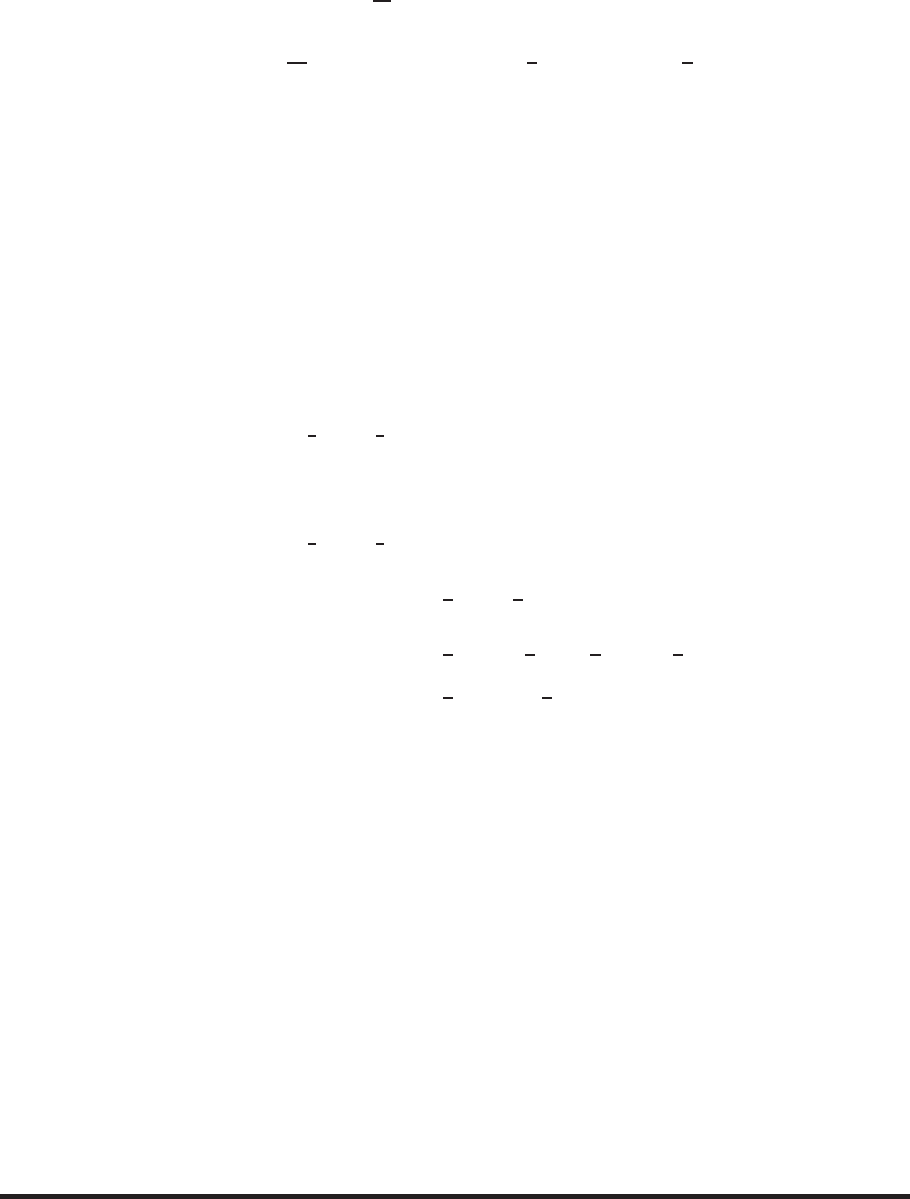
1674 Chapter Eighteen /SOLUTIONS
18. Since ~
F= (x+ 2)
~
i+ (2y+ 3)~
j= grad x2
2+ 2x+y2+ 3y, the Fundamental Theorem of Line Integrals gives
ZC
~
F·d~r =x2
2+ 2x+y2+ 3y
(3,1)
(1,0)
=9
2+ 6 + 1 + 3−1
2+ 2= 12.
19. Since ~
F= 2 sin(2x+y)
~
i+ sin(2x+y)~
j= grad(−cos(2x+y)), we take
f(x, y) = −cos(2x+y).
Then, using the Fundamental Theorem of Line Integrals,
ZC
~
F·d~r =f(0,5π)−f(π, 0) = −cos(5π)−(−cos(2π)) = −(−1) −(−1) = 2.
Notice that only the endpoints of the curve affect the answer.
20. Since ~
F= 2x
~
i−4y~
j+ (2z−3)~
k= grad(x2−2y2+z2−3z), the Fundamental Theorem of Line Integrals gives
ZC
~
F·d~r = (x2−2y2+z2−3z)
(2,3,−1)
(1,1,1)
= (4 −2·32+ (−1)2+ 3) −(12−2·12+ 12−3) = −7.
21. Since ~
F=x2/3
~
i+e7y~
j= grad 3
5x5/3+1
7e7y, we see ~
Fis a gradient vector field. Therefore,
ZC
(x2/3
~
i+e7y~
j)·d~r = 0.
22. Since ~
F=x2/3
~
i+e7y~
j= grad 3
5x5/3+1
7e7y, we have
ZC
(x2/3
~
i+e7y~
j)·d~r =3
5x5/3+1
7e7y
(0,1)
(1,0)
=3
5·05/3+1
7e7·1−3
5·15/3−1
7e7·0
=1
7(e7−1) −3
5.
23. Since ~
F= grad(exy + sin z), we take f(x, y, z) = exy + sin zand use the Fundamental Theorem of Line Integrals
ZC
~
F·d~r =f(3,1,9π)−f(0,0, π) = e3+ sin (9π)−e0−sin π
=e3−1.
24. Since ~
F=ysin(xy)
~
i+xsin(xy)~
j= grad(−cos(xy)), the Fundamental Theorem of Line Integrals gives
ZC
~
F·d~r =−cos(xy)
(3,18)
(1,2)
=−cos(54) + cos(2) = cos(2) −cos(54).
25. Since ~
F= 2xy2zex2y2z~
i+2x2yzex2y2z~
j+x2y2ex2y2z~
k= grad(ex2y2z)and the curve Cis closed, the Fundamental
Theorem of Line Integrals tells us that RC~
F·d~r = 0, since
ZC
~
F·d~r =ex2y2z
(1,0,1)
(1,0,1)
=e0−e0= 0.
Problems
26. Since ~v is a gradient field, the end point should be (5,4), the point with largest value of f=x2+y2, and the starting
point should be (0,0), the point with smallest f.

18.3 SOLUTIONS 1675
27. Since ~
Fis a gradient field, to maximize RC~v ·d~r we need to choose the path with the end point that makes 2x2+ 3y2as
large as possible and with the starting point that makes 2x2+ 3y2as small as possible. Path P Q satisfies these conditions.
28. The vector field is a gradient field since
cos(xy)esin(xy)(y~
i+x~
j) + ~
k= grad(esin(xy)+z),
so we use the Fundamental Theorem of Line Integrals:
ZCcos(xy)esin(xy)(y~
i+x~
j) + ~
k·d~r =esin(xy)+z
(0.5,π,7)
(π,2,5)
=esin(π/2) + 7 −esin 2π−5
=e+ 7 −1−5
=e+ 1.
29. The vector field ~
Fpoints radially outward, and so is everywhere perpendicular to A; thus, RA~
F·d~r = 0.
Along the first half of B, the terms ~
F·∆~r are negative; along the second half the terms ~
F·∆~r are positive. By
symmetry the positive and negative contributions cancel out, giving a Riemann sum and a line integral of 0.
The line integral is also 0along C, by cancellation. Here the values of ~
Falong the x-axis have the same magnitude
as those along the y-axis. On the first half of Cthe path is traversed in the opposite direction to ~
F; on the second half of
Cthe path is traversed in the same direction as ~
F. So the two halves cancel.
30. We parameterize Aby x=t,y=t, where 0≤t≤1. Then
ZA
~
F·d~r =Z1
0
(t
~
i+t~
j)·(
~
i+~
j)dt
=Z1
0
2t dt =t2
1
0
= 1.
The path Bhas the parameterization x=t,y=t2, where 0≤t≤1. Then we have
ZB
~
F·d~r =Z1
0
(t
~
i+t2~
j)·(
~
i+ 2t~
j)dt
=Z1
0
(t+ 2t3)dt =t2
2+2t4
4
1
0
=1.
We have to break the path Cinto two separate parameterizations: x=t,y= 0, where 0≤t≤1and x= 1,y=t,
where 0≤t≤1. Then
ZC
~
F·d~r =Z1
0
(t
~
i·~
i)dt +Z1
0
(
~
i+t~
j)·~
j dt
=Z1
0
tdt +Z1
0
t dt =1
2+1
2= 1.
31. Yes. If f(x, y) = 1
2x2, then grad f=x
~
i.
32. Yes. If f(x, y) = 1
3x3−xy2, then grad f= (x2−y2)
~
i−2xy~
j.
33. Yes. Let
f(~r ) = −1
r=−(x2+y2+z2)−1/2
Then
∂f
∂x =x(x2+y2+z2)−3/2
∂f
∂y =y(x2+y2+z2)−3/2
∂f
∂z =z(x2+y2+z2)−3/2
So grad f= (x2+y2+z2)−3/2(x
~
i+y~
j+z~
k) = ~r /r3
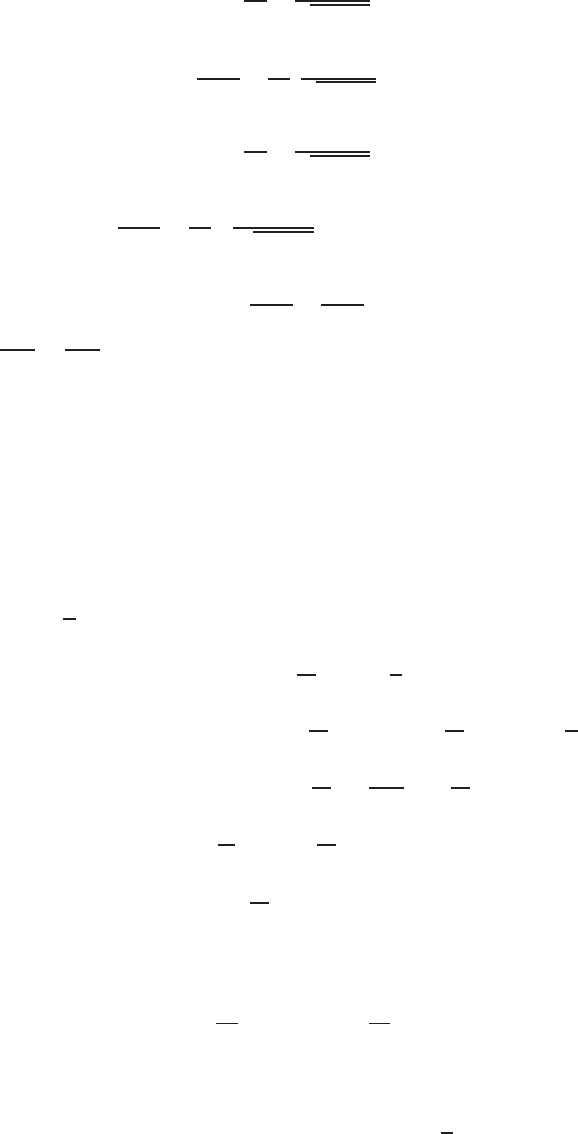
1676 Chapter Eighteen /SOLUTIONS
34. No. Suppose there were a function fsuch that grad f=~
F. Then we would have
∂f
∂x =−z
√x2+z2.
Hence we would have
∂2f
∂y∂x =∂
∂y (−z
√x2+z2) = 0.
In addition, since grad f=~
F, we have that
∂f
∂y =y
√x2+z2.
Thus we also know that
∂2f
∂x∂y =∂
∂x y
px2+y2!=−xy(x2+z2)−3/2.
Notice that
∂2f
∂y∂x 6=∂2f
∂x∂y .
Since we expect ∂2f
∂y∂x =∂2f
∂x∂y , we have got a contradiction. The only way out of this contradiction is to conclude there
is no function fwith grad f=~
F. Thus ~
Fis not a gradient vector field.
35. Since ~
F(x, y, z) = grad(ex2+yz ), we use the Fundamental Theorem of line integrals
ZC
~
F·d~r =ZC
grad ex2+yz ·d~r =ex2+yz
(3,0,0)
(0,0,0)
=e9−e0=e9−1.
36. (a) To find the change in fby computing a line integral, we first choose a path Cbetween the points; the simplest is a
line. We parameterize the line by (x(t), y(t)) = (t, πt/2), with 0≤t≤1. Then (x′(t), y′(t)) = (1, π/2), so the
Fundamental Theorem of Line Integrals tells us that
f(1,π
2)−f(0,0) = ZC
grad f·d~r
=Z1
0
grad ft, πt
2·~
i+π
2~
jdt
=Z1
02tet2sin πt
2~
i+et2cos πt
2~
j·~
i+π
2~
jdt
=Z1
02tet2sin πt
2+πet2
2cos πt
2dt
=Z1
0
d
dt et2sin πt
2dt
=et2sin πt
2
1
0
=e= 2.718.
This integral can also be approximated numerically.
(b) The other way to find the change in fbetween these two points is to first find f. To do this, observe that
2xex2sin y~
i+ex2cos y~
j=∂
∂x ex2sin y~
i+∂
∂y ex2sin y~
j= grad ex2sin y.
So one possibility for fis f(x, y) = ex2sin y. Thus,
Change in f
(1,π/2)
(0,0)
=ex2sin y
(1,π/2)
(0,0)
=e1sin π
2−e0sin 0 = e.
The exact answer confirms our calculations in part (a) which show that the answer is e.
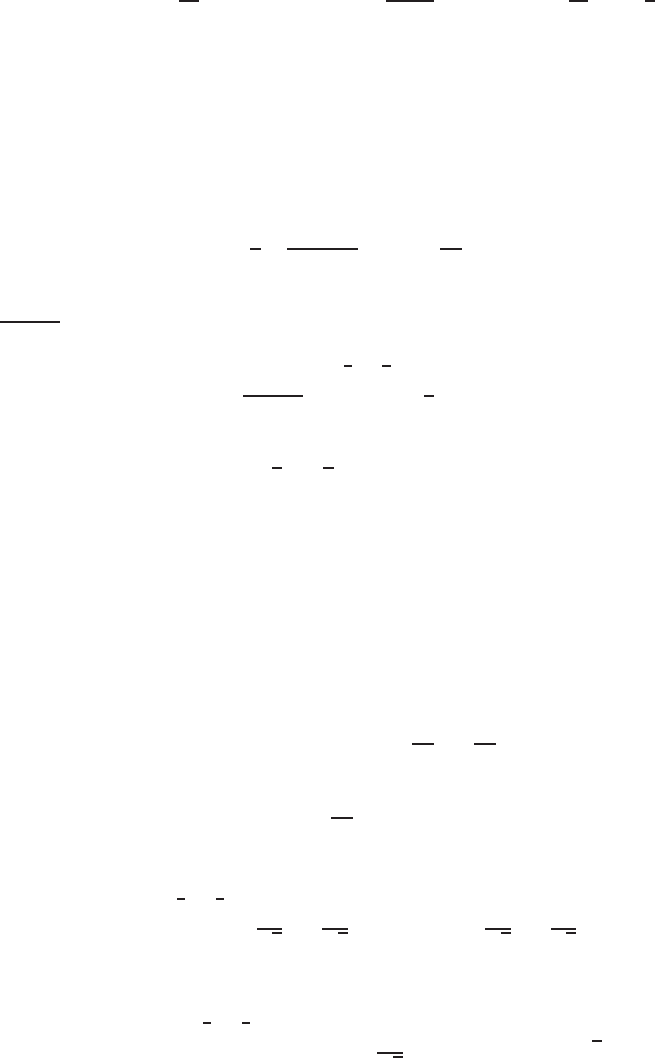
18.3 SOLUTIONS 1677
37. The unit circle cuts the negative x-axis at (−1,0,0), and it cuts the negative y-axis at (0,−1,0). There is a quarter circle
between these points if the circle is traversed counterclockwise.
(a) Since 2πx
~
i+y2~
j= grad(πx2+y3/3), we use the Fundamental Theorem of Line Integrals:
ZC
(2πx
~
i+y2~
j)·d~r =πx2+y3
3
(0,−1,0)
(−1,0,0)
=π(02) + (−1)3
3−π(−1)2+03
3=−1
3−π.
(b) Since ~
Fis not a gradient field, we parameterize c. If x= cos tand y= sin t, then π≤t≤3π/2parametrizes C.
Thus
ZC
(−2y~
i+x~
j)·d~r =Z3π/2
π
(−2 sin t
~
i+ cos t~
j)·(−sin t
~
i+ cos t~
j)dt
=Z3π/2
π
(2 sin2t+ cos2t)dt =Z3π/2
π
(1 + sin2t)dt
=t+t
2−sin tcos t
2
3π/2
π
=3π
4.
38. Since ~
F= grad x2+y2
2, the line integral can be calculated using the Fundamental Theorem of Line Integrals:
Zc
~
F·d~r =x2+y2
2
(3/√2,3/√2)
(0,0)
=9
2.
39. This vector field is not a gradient field, so we evaluate the line integral directly. Let C1be the path along the x-axis from
(0,0) to (3,0) and let C2be the path from (3,0) to (3/√2,3/√2) along x2+y2= 9. Then
ZC
~
H·d~r =ZC1
~
H·d~r +ZC2
~
H·d~r .
On C1, the vector field has only a ~
jcomponent (since y= 0), and ~
His therefore perpendicular to the path. Thus,
ZC1
~
H·d~r = 0.
On C2, the vector field is tangent to the path. The path is one eighth of a circle of radius 3 and so has length 2π(3/8) =
3π/4.ZC2
~
H·d~r =k~
Hk · Length of path = 3 ·3π
4=9π
4.
Thus, ZC
~
H·d~r =9π
4.
40. Since ~
F= grad(yln(x+ 1)), we evaluate the line integral using the Fundamental Theorem of Line Integrals:
ZC
~
F·d~r =yln(x+ 1)
(3/√2,3/√2)
(0,0)
=3
√2ln 3
√2+ 1−0 ln 1 = 3
√2ln 3
√2+ 1.
41. Since ~
G= grad(exy + sin(x+y)), the line integral can be calculated using the Fundamental Theorem of Line Integrals:
Zc
~
F·d~r =exy + sin(x+y)
(3/√2,3/√2)
(0.0)
=e9/2+ sin 6
√2−e0=e9/2+ sin(3√2) −1.

1678 Chapter Eighteen /SOLUTIONS
42. Since ~
F=yz2exyz2
~
i+xz2exyz2~
j+ 2xyzexyz2~
k= grad(exyz2), we can use the Fundamental Theorem of Line
Integrals. The start of the path, where t= 0, is (1,0,0). The end of the path is (cos(1.25π),sin(1.25π),1.25π) =
(−1/√2,−1/√2,1.25π). Thus
ZC
~
F·d~r =exyz2
(−1/√2,−1/√2,1.25π)
(1,0,0)
=e(1.25π)2/2−1.
43. Since ~
F= grad(x2+y2+z2), by the Fundamental Theorem of Line Integrals we have
ZC
~
F·d~r =ZC
grad(x2+y2+z2)·d~r = (x2+y2+z2)
(1,5,9)
(0,0,0)
= 12+ 52+ 92= 107.
Since ~
G=~
F+y~
i, we have
ZC
~
G·d~r =ZC
~
F·d~r +ZC
y~
i·d~r = 107 + ZC
y~
i·d~r .
To find ZC
y~
i·d~r , we parameterize the line by ~r =t
~
i+ 5t~
j+ 9t~
k, for 0≤t≤1. We have ~r ′(t) = ~
i+ 5~
j+ 9~
k, so
ZC
y~
i·d~r =Z1
0
5t
~
i·(
~
i+ 5~
j+ 9~
k)dt =Z1
0
5t dt =5t2
2
1
0
=5
2.
Thus, ZC
~
G·d~r =ZC
~
F·d~r +ZC
y~
i·d~r = 107 + 5
2= 109.5.
44. (a) Since ~
F= grad(yex), we can use the Fundamental Theorem which says that
ZC
~
F·d~r =yex
(3,7)
(1,2)
= 7e3−2e1.
It does not matter how the curve goes because the Fundamental Theorem gives the line integral in terms of the values
of the function f(x, y) = yexat the end points only.
(b) The line is given by ~r =~
i+ 2~
j+t(2
~
i+ 5~
j) = (1 + 2t)
~
i+ (2 + 5t)~
j. Thus, r′(t) = 2
~
i+ 5~
j, so
ZC
~
F·d~r =Z1
0(2 + 5t)e1+2t
~
i+e1+2t~
j·(2
~
i+ 5~
j)dt =Z1
0
(4 + 10t+ 5)e1+2tdt
=9e1+2t
2
1
0
+ 10 Z1
0
te1+2tdt.
Using integration by parts with u=t, u′= 1, v′=e1+2t, v =e1+2t/2for the second integral, we get
ZC
~
F·d~r =9
2(e3−e1) + 10 te1+2t
2
1
0−Z1
0
e1+2t
2dt!
=9
2(e3−e1) + 5e3−5e1+2t
2
1
0
=9
2(e3−e1) + 5e3−5
2(e3−e1)
= 7e3−2e.
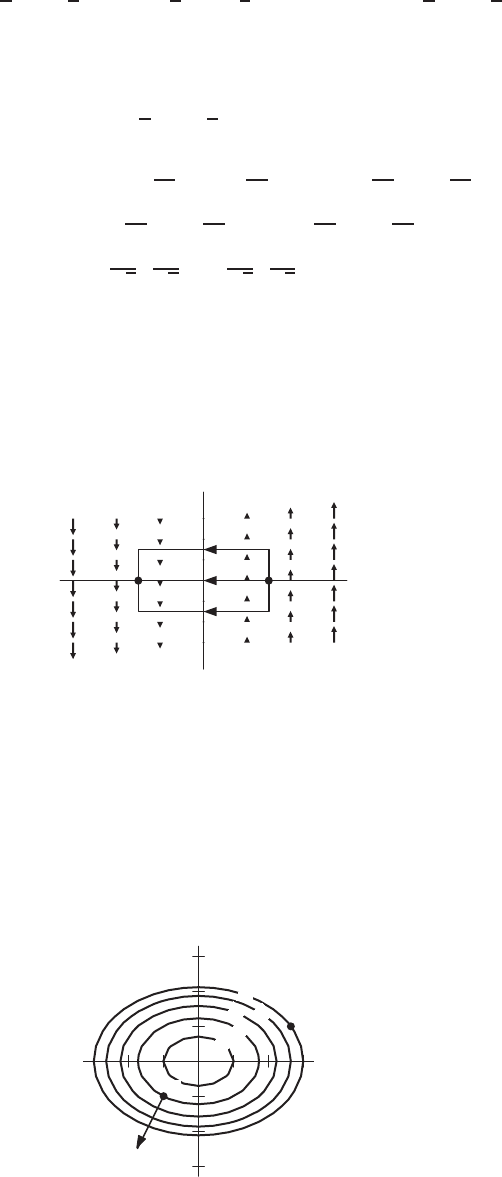
18.3 SOLUTIONS 1679
45. Although this curve is complicated, the vector field is a gradient field since
~
F= sin x
2sin y
2~
i−cos x
2cos y
2~
j= grad −2 cos x
2sin y
2.
Thus, only the endpoints of the curve, Pand Q, are needed. Since P= (−3π/2,3π/2) and Q= (−3π/2,−3π/2) and
~
F= grad(−2 cos(x/2) sin(y/2)), we have
ZC
~
F·d~r =−2 cos x
2sin y
2
Q=(−3π/2,−3π/2)
P=(−3π/2,3π/2)
=−2 cos −3π
4sin −3π
4+ 2 cos −3π
4sin 3π
4
= 2 cos 3π
4sin 3π
4+ 2 cos 3π
4sin 3π
4
=−2·1
√2·1
√2−2·1
√2·1
√2=−2.
46. (a) By the Fundamental Theorem of Line Integrals
Z(3,4)
(0,2)
grad f·d~r =f(3,4) −f(0,2) = 66 −57 = 9.
(b) By the Fundamental Theorem of Line Integrals, since Cis a closed path, RCgrad f·d~r = 0.
47. (a) Three possible paths are shown in Figure 18.20.
C1
C3
C2
Q P x
y
Figure 18.20
Since ~
Fis perpendicular to the horizontal axis everywhere, ~
F·~
dr = 0 along C1.
Since C2starts out in the direction of ~
F , the first leg of C2will have a positive line integral. The second
horizontal part of C2will have a 0 line integral, and the third leg that ends at Q will have a positive line integral. Thus
the line integral along C2is positive.
A similar argument shows that the line integral along C3<0.
(b) No, ~
Fis not a gradient field, since the line integrals along these three paths joining Pand Qdo not have the same
value.
48. (a) See Figure 18.21.
P
Q
1
3
5
7
9
x
y
Figure 18.21

1680 Chapter Eighteen /SOLUTIONS
(b) Vector at Pis shorter than vector at Q.
(c) By the Fundamental Theorem of Line Integrals
ZC
grad f·d~r =f(Q)−f(P) = 9 −3 = 6.
49. Since ~
Fis a gradient vector field, we use the Fundamental Theorem of line integrals, giving
ZC
~
F·d~r =ZC
grad f·d~r =f(end)−f(start).
(a) The line integral RC2
~
F·d~r is 0, since the curve begins and ends on the same contour, so f(end) = f(start).
(b) Since C1crosses more contours than C4, and since both curves are oriented in the direction of increasing f,
0<ZC4
~
F·d~r < ZC1
~
F·d~r .
Since C3goes from higher to lower values of f,
ZC3
~
F·d~r < 0 = ZC2
~
F·d~r .
Thus, we have ZC3
~
F·d~r < ZC2
~
F·d~r < ZC4
~
F·d~r < ZC1
~
F·d~r .
(c) Since C3and C4have endpoints on the same contours, but with start and finish reversed,
ZC3
~
F·d~r =−ZC4
~
F·d~r .
The line integral RC3
~
F·d~r is negative because Q3is on a contour of lower value than P3.
50. (a) The integral is positive, because the portion of the path that goes with the vector field is longer than the portion of the
path that goes against it, and in addition the vectors are larger in magnitude along the former and smaller in magnitude
along the latter.
(b) If it were true that ~
F= grad ffor some function f, then the integral around every closed path would be zero. But
in part (a) we saw that the integral around one closed path was not zero, so ~
Fcannot be a gradient vector field.
(c) The region shown is in the first quadrant. In that quadrant, the vectors of ~
F1point away from the origin, so ~
F1does
not fit. The vectors of both ~
F2and ~
F3point up and to the left, so they are both possibilities; of these, ~
F2fits best
because its vectors get larger in magnitude as you move away from the origin, which fits the diagram. The vectors in
~
F3shrink as you move away from the origin.
51. Since the vector field is path independent, the line integral around the closed curve (0,0) to (1,0) to (1,1) to (0,1) to
(0,0) is zero. Thus
Z(0,0)
(0,1)
~
F·d~r =−Z(1,0)
(0,0)
~
F·d~r +Z(1,1)
(1,0)
~
F·d~r +Z(0,1)
(1,1)
~
F·d~r =−(5.1 + 3.2−4.7) = −3.6.
52. (a) To maximize the line integral, we choose Cto be parallel to grad f= 3
~
i+ 4~
j. Thus Chas parametric equation
~r = (2
~
i+~
j) + t~v where ~v = 3
~
i+ 4~
j, so
x= 2 + 3t y = 1 + 4t.
If the other end of Cis at (x1, y1), since the length of Cis 10, we have
p(x1−2)2+ (y1−1)2= 10
p(3t)2+ (4t)2= 10
tp32+ 42= 10
5t= 10
t= 2.
18.3 SOLUTIONS 1681
Thus t= 2 at (x1, y1), so
x1= 2 + 2 ·3 = 8 and y1= 1 + 2 ·4 = 9.
Thus Cends at the point (8,9).
(b) By the Fundamental Theorem of Line Integrals,
ZC
grad f·d~r =f(8,9) −f(2,1) = (3 ·8 + 4 ·9) −(3 ·2 + 4 ·1) = 50.
Alternately, since grad fand Care parallel,
ZC
grad f·d~r =kgrad fk · Length of C= 5 ·10 = 50.
53. (a) Since ~r ·~a =a1x+a2y+a3z, we have
grad(~r ·~a ) = a1
~
i+a2~
j+a3~
k=~a .
(b) By the Fundamental Theorem of Line Integrals, if ~r0=x0
~
i+y0~
j+z0~
k, we have
ZC
grad(~r ·~a )·d~r =~r ·~a
(x0,y0,z0)
(0,0,0)
=~r 0·~a .
(c) Since ~r 0·~a =||~r 0||||~a ||cos θ= 10||~a ||cos θ, where the angle between ~r 0and ~a , the maximum value of ~r 0·~a
occurs if ~r 0is parallel to ~a . Then θ= 0 and
ZC
grad(~r ·~a )·d~r = 10||~a ||cos 0 = 10||~a ||.
54. (a) Work done by the force is the line integral, so
Work done against force =−ZC
~
F·d~r =−ZC
(−mg ~
k)·d~r .
Since ~r = (cos t)
~
i+ (sin t)~
j+t~
k , we have ~r ′=−(sin t)
~
i+ (cos t)~
j+~
k,
Work done against force =Z2π
0
mg~
k·(−sin t
~
i+ cos t~
j+~
k)dt
=Z2π
0
mg dt = 2π mg.
(b) We know from physical principles that the force is conservative. (Because the work done depends only on the vertical
distance moved, not on the path taken.) Alternatively, we see that
~
F=−mg ~
k= grad(−mgz),
so ~
Fis a gradient field and therefore path independent, or conservative.
55. (a) We parameterize the path by (cos t, sin t)for π/2≤t≤π. Since t=π/2gives the end point, (0,1) and t=π
gives the starting point (−1,0), we have
ZC
~
F·~
dr=Zπ/2
π
~
F(cos t, sin t)·(−sin t
~
i+ cos t~
j)dt
=−Zπ
π/2
(sin t
~
i−cos t~
j)·(−sin t
~
i+ cos t~
j)dt
=−Zπ
π/2
(−sin2t−cos2t)dt
=Zπ
π/2
1dt =t
π
π/2
=π/2.
The work done by the force is +π/2. The work is positive since the force is always in the direction of the path (in
fact it is always tangent to Csince ~
F·~r = 0).
(b) If we redo our computations using the entire unit circle, the only change will be the limits of integration: they’ll
change to 0to 2π. This yields an answer of 2π(or −2π, depending on orientation). Since the work around a closed
path is not zero, the force is not path-independent.
1682 Chapter Eighteen /SOLUTIONS
56. (a) Since ~
F(x, y)−~
G(x, y)is parallel to grad h(x, y), it is perpendicular to the level curves of h. Since the oriented
path Cis on a level curve of h,~
F(x, y)−~
G(x, y)is perpendicular to Cat every point of C. Hence
ZC
(~
F(x, y)−~
G(x, y)) ·d~r = 0.
Therefore ZC
~
F·d~r =ZC
~
G·d~r .
(b) By the Fundamental Theorem of Calculus for Line Integrals we have
ZC
~
G·d~r =ZC
grad φ·d~r =φ(Q)−φ(P).
Using part (a) we have ZC
~
F·d~r =φ(Q)−φ(P).
57. (a) We have
grad h=~
j
grad φ=y~
i+x~
j
~
F−grad φ=x~
j=xgrad h.
Thus, ~
F−grad φis a multiple of grad h.
(b) By part (a) the vector fields ~
Fand grad φhave the same components perpendicular to grad h, which is to say the
same components in the direction of the level curve Cof h. Thus, the line integrals of ~
Fand grad φalong Care
equal. Using the Fundamental Theorem of Calculus for Line Integrals, we have
ZC
~
F·d~r =ZC
grad φ·d~r =φ(Q)−φ(P) = 80 −30 = 50.
58. (a) We have
grad h=~
i
grad φ= 2y~
i+ 2x~
j
~
F−grad φ=−y~
i=−ygrad h.
Thus, ~
F−grad φis a multiple of grad h.
(b) By part (a) the vector fields ~
Fand grad φhave the same components perpendicular to grad h, which is to say the
same components in the direction of the level curve Cof h. Thus, the line integrals of ~
Fand grad φalong Care
equal. Using the Fundamental Theorem of Calculus for Line Integrals, we have
ZC
~
F·d~r =ZC
grad φ·d~r =φ(Q)−φ(P) = 60 −30 = 30.
59. (a) We have
grad h=−2x
~
i+~
j
grad φ= (2x2+y)
~
i+x~
j
~
F−grad φ=−2x2
~
i+x~
j=xgrad h.
Thus, ~
F−grad φis a multiple of grad h.
(b) By part (a) the vector fields ~
Fand grad φhave the same components perpendicular to grad h, which is to say the
same components in the direction of the level curve Cof h. Thus, the line integrals of ~
Fand grad φalong Care
equal. Using the Fundamental Theorem of Calculus for Line Integrals, we have
ZC
~
F·d~r =ZC
grad φ·d~r =φ(Q)−φ(P) = 384 −0 = 384.
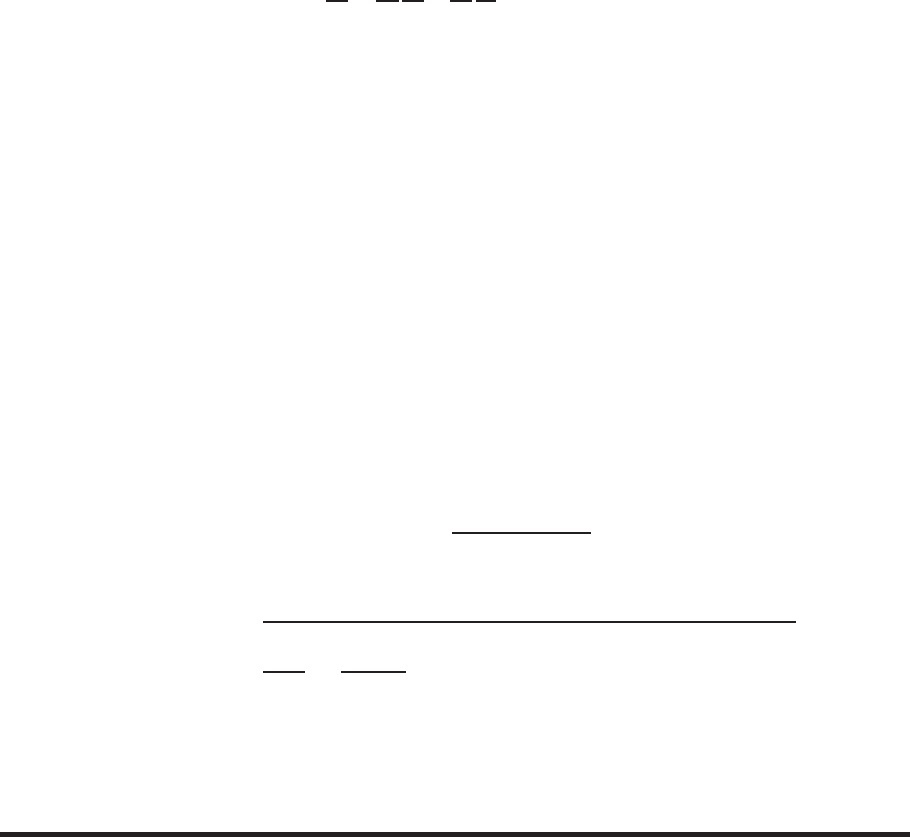
18.3 SOLUTIONS 1683
60. (a) We have
grad h=~
i+~
j
grad φ= (x+ 3y)
~
i+ (3x+ 2y)~
j
~
F−grad φ= (−x−2y)
~
i+ (−x−2y)~
j=−(x+ 2y) grad h.
Thus, ~
F−grad φis a multiple of grad h.
(b) By part (a) the vector fields ~
Fand grad φhave the same components perpendicular to grad h, which is to say the
same components in the direction of the level curve Cof h. Thus, the line integrals of ~
Fand grad φalong Care
equal. Using the Fundamental Theorem of Calculus for Line Integrals, we have
ZC
~
F·d~r =ZC
grad φ·d~r =φ(Q)−φ(P) = 1800 −1850 = −50.
61. (a) By the chain rule
dh
dt =∂f
∂x
dx
dt +∂f
∂y
dy
dt =fxx′(t) + fyy′(t),
which is the result we want.
(b) Using the parameterization of Cthat we were given,
ZC
grad f·d~r =Zb
a
(fx(x(t),y(t))
~
i+fy(x(t), y(t))~
j)·(x′(t)
~
i+y′(t)~
j)dt
=Zb
a
(fx(x(t),y(t))x′(t) + fy(x(t), y(t))y′(t))dt.
Using the result of part (a), this gives us
ZC
grad f·d~r =Zb
a
h′(t)dt
=h(b)−h(a) = f(Q)−f(P).
62. (a) The level surfaces are horizontal planes given by gz =c, so z=c/g. The potential energy increases with the height
above the earth. This means that more energy is stored as “potential to fall” as height increases.
(b) The gradient of φpoints upward (in the direction of increasing potential energy), so ∇φ=g~
k. The gravitational
force acts toward the earth in the direction of −~
k. So, ~
F=−g~
k. The negative sign represents the fact that the
gravitational force acts in the direction of the decreasing potential energy.
63. (a) We have
ϕ(~r ) = p1x+p2y+p3z
(x2+y2+z2)3/2.
Taking partial derivatives gives
ϕx(~r ) = p1(x2+y2+z2)3/2−(3/2)(p1x+p2y+p3z)(2x)(x2+y3+z2)1/2
(x2+y2+z3)3
=p1
||~r ||3−3(~p ·~r )x
||~r ||5
=−D1(~r ).
Similar computations give ϕy=−D2and ϕz=−D3, so grad ϕ=−~
D .
(b) The field ~
Dis necessarily path-independent since it is a gradient vector field.
Strengthen Your Understanding
64. The statement cannot be correct, because RC~
F·d~r is a scalar and ~
F(Q)−~
F(P)is a vector. The correct statement of
the Fundamental Theorem of Calculus for Line Integrals is as follows: if ~
F= grad f, then RC~
F·d~r =f(Q)−f(P).
Evaluate the potential function, f, for ~
F, not ~
Fitself, at the endpoints of C.
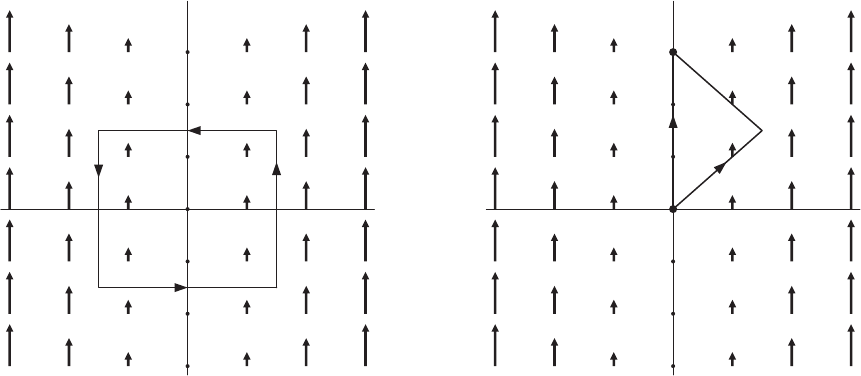
1684 Chapter Eighteen /SOLUTIONS
65. This is only true if ~
Fis path-independent; if it is not, then fis not well-defined.
66. If a vector field ~
Fis not a gradient vector field, then RC~
F·d~r can’t be evaluated using the Fundamental Theorem of
Calculus for Line Integrals. However, other methods such as parameterizing Cmight work to evaluate the integral.
67. The integral is required to have the same value for all oriented paths from (0,0) to (1,2). This is achieved by choosing
~
F= grad fto be a gradient vector field. Since RCgrad f·d~r =f(1,2) −f(0,0), we seek a function f(x, y)such that
f(1,2) −f(0,0) = 100. For example, we can take f(x, y) = 50xy. With
~
F= grad f= 50y~
i+ 50x~
j
we have ZC
~
F·d~r = 100.
68. Every gradient field is path-independent. For example,
~
F= grad xy =y~
i+x~
j
is path-independent.
69. A path-independent vector field must have zero circulation around all closed paths. Consider a vector field like ~
F(x, y) =
|x|~
j, shown in Figure 18.22.
A rectangular path that is symmetric about the y-axis will have zero circulation: on the horizontal sides, the field is
perpendicular, so the line integral is zero. The line integrals on the vertical sides are equal in magnitude and opposite in
sign, so they cancel out, giving a line integral of zero. However, this field is not path-independent, because it is possible to
find two paths with the same endpoints but different values of the line integral of ~
F. For example, consider the two points
(0,0) and (0,1). The path C1in Figure 18.23 along the yaxis gives zero for the line integral, because the field is 0along
the yaxis, whereas a path like C2will have a nonzero line integral. Thus the line integral depends on the path between
the points, so ~
Fis not path-independent.
y
x
Figure 18.22
C1C2
x
y
(0,0)
(0,1)
Figure 18.23
70. This is false, because the line integral yields a scalar whereas the total change in ~
Fwould be a vector. In the special case
when ~
Fhappens to be the gradient of a scalar function f, the line integral does give the total change of the scalar function
falong the path—but not of the vector function ~
F.
71. You can easily come up with counterexamples: suppose that ~
F6=~
Gbut that both are gradient fields. For example,
~
F=~
iand ~
G=~
j. Then, if Cis a closed curve, the line integral around Cof both ~
Fand ~
Gwill equal to zero. But this
does not mean that ~
F=~
G.
72. The total change of falong Cdepends only on the endpoints of C. If fhas the same values at each endpoint (or if Cis
closed, so that the endpoints coincide) then the total change will be zero. This in no way restricts the shape of the curve
C. For example, take f(x, y) = x2+y2and Cto be the straight line from the point (1,0) to the point (0,1). Then
f(1,0) = f(0,1) = 1 so the change in falong Cis zero, but Cis not a contour of f.
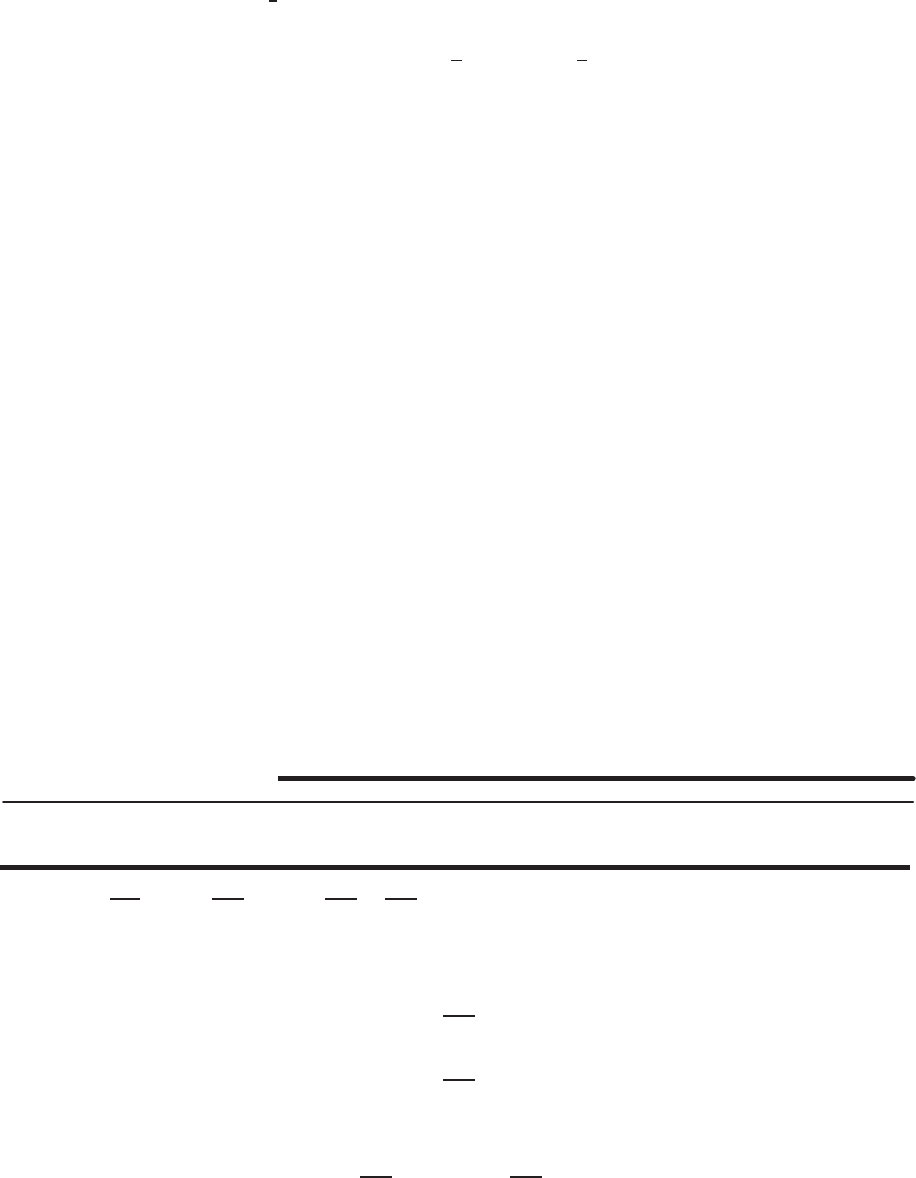
18.4 SOLUTIONS 1685
73. False. The line integral of a gradient vector field around this circle would be 0, but the converse is not necessarily true.
That is, the fact that the line integral around this one circle is zero does not mean ~
Fis necessarily a gradient field.
74. True. Since x
~
i+y~
j= grad 1
2(x2+y2), the Fundamental Theorem of Line Integrals gives
ZC
(x
~
i+y~
j)·d~r =1
2(x2+y2)
(a,b)
(0,0)
1
2(a2+b2).
75. False. The line integrals of many vector fields (so called path independent or conservative fields) are zero around closed
curves, but this is not true of all fields. For example, a vector field that is flowing in the same direction as the curve Call
along the curve has a positive line integral. A specific example is given by ~
F=−y~
i+x~
j, where Cis the unit circle
centered at the origin, oriented counterclockwise.
76. True. By the Fundamental Theorem for Line Integrals, if Cis a path from Pto Q, then ZC
grad f·d~r =f(Q)−f(P),
so the value of the line integral RCgrad f·d~r depends only on the endpoints and not the path.
77. False. The statement is true if C1and C2have the same initial and final points. For example, ~
F(x, y) = ~
iis path-
independent (since it is the gradient of f(x, y) = x), but the line integral of ~
Fover a path from (0,0) to (1,0) is
f(1,0) −f(0,0) = 1, but the line integral over a path from (0,0) to (0,1) is f(0,1) −f(0,0) = 0.
78. False. However, if ~
Fis a gradient field, the line integral gives the total change in the potential function f, where ~
F=
grad f.
79. True. The construction at the end of Section 18.3 shows how to make a potential function from a path-independent vector
field.
80. True. Since a gradient field is path-independent, and C1and C2have the same initial and final points, the two line integrals
are equal.
81. True. Since the curve can be thought of as having the same initial and final points, if fis a potential function for ~
Fwe
have RC~
F·d~r =RCgrad f·d~r =f(P)−f(P) = 0.
82. False. If there were a potential function f, then fx=y2, so f(x, y) = xy2+g(y), where g(y)is a function of yonly.
Then fy= 2xy +g′(y), which depends on xno matter what g′(y)is. Thus fycannot be equal to a constant k, and so
there is no potential function fsuch that ~
F= grad f.
83. False. For example, take ~
F=y~
i. By symmetry, the line integral of ~
Fover any circle centered at the origin is zero.
But the curve consisting of the upper semicircle connecting (−a, 0) to (a, 0) has a positive line integral, while the line
connecting these points along the x-axis has a zero line integral, so the field cannot be path-independent.
Solutions for Section 18.4
Exercises
1. We have ∂Fi
∂y = 1 and ∂F2
∂x =−1, so ∂F1
∂y 6=∂F2
∂x and this cannot be a gradient vector field.
2. Yes, since ~
F= 2xy~
i+x2~
j= grad(x2y).
3. The domain of the vector field ~
F(x, y) = y~
i+y~
jis the whole xy-plane. In order to see if ~
Fis a gradient let us apply
the curl test: ∂F1
∂y = 1
and ∂F2
∂x = 0
So ~
Fis not the gradient of any function.
4. No, since if ~
F= 2xy~
i+ 2xy~
j,
∂F2
∂x = 2yand ∂F1
∂y = 2x,

1686 Chapter Eighteen /SOLUTIONS
so ∂F2
∂x −∂F1
∂y 6= 0.
5. The domain of the vector field ~
F(x, y) = (x2+y2)
~
i+ 2xy~
jis the whole xy-plane. Let us apply the curl test:
∂F1
∂y = 2y=∂F2
∂x
so ~
Fis the gradient of some function f. In order to compute fwe first integrate
∂f
∂x =x2+y2
with respect to x, thinking of yas a constant.
We get
f(x, y) = x3
3+xy2+C(y)
Differentiating with respect to yand using the fact that ∂f/∂y = 2xy gives
∂f
∂y = 2xy +C′(y) = 2xy
Thus C′(y) = 0 so Cis a constant and
f(x, y) = x3
3+xy2+C.
6. The domain of the vector field ~
F= (2xy3+y)
~
i+ (3x2y2+x)~
jis the whole xy-plane. We apply the curl test:
∂F1
∂y = 6xy2+ 1 = ∂F2
∂x
so ~
Fis the gradient of a function f. In order to compute fwe first integrate
∂f
∂x = 2xy3+y
with respect to xthinking of yas a constant. We get
f(x, y) = x2y3+xy +C(y)
Differentiating with respect to yand using the fact that ∂f/∂y = 3x2y2+xgives
∂f
∂y = 3x2y2+x+C′(y) = 3x2y2+x
Thus C′(y) = 0 so Cis constant and
f(x, y) = x2y3+xy +C.
7. The domain of the vector field ~
F=~
i
x+~
j
y+~
k
zis the set of points (x, y, z)in the three space such that x6= 0,y6= 0
and z6= 0. This is what is left in the three space after removing the coordinate planes. This domain has the property that
every closed curve is the boundary of a surface entirely contained in it, hence we can apply the curl test.
curl ~
F=
~
i~
j~
k
∂
∂x
∂
∂y
∂
∂z
1
x
1
y
1
z
So curl ~
F=~
0and thus ~
Fis the gradient of a function f. In order to compute fwe first integrate
∂f
∂x =1
x
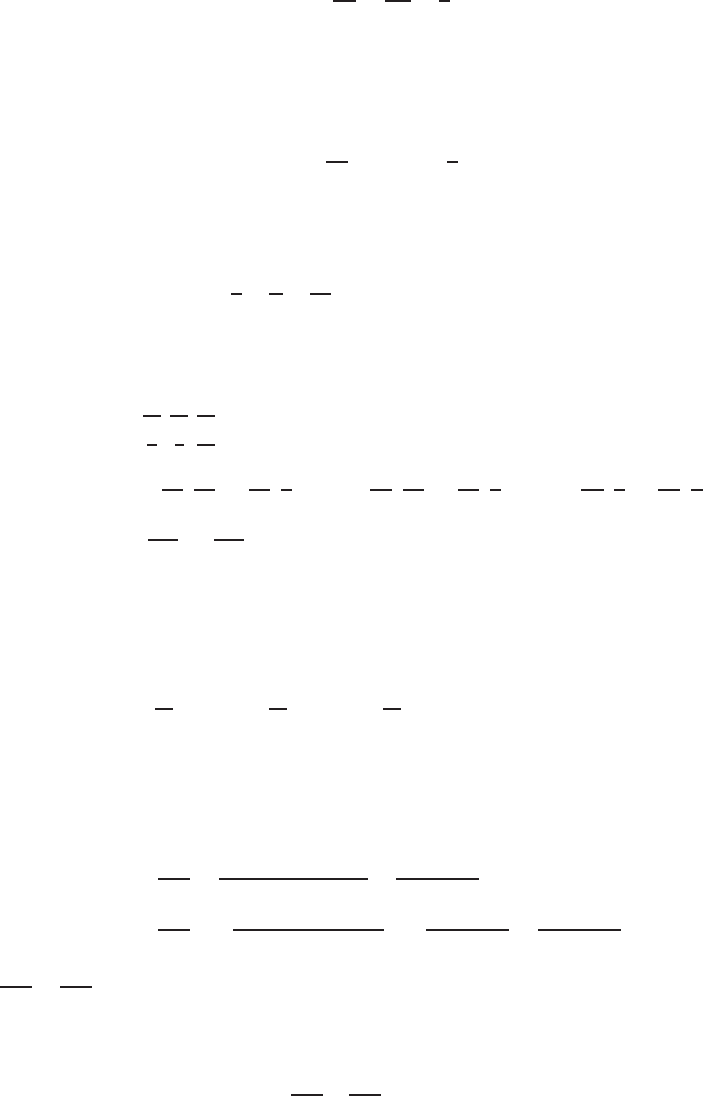
18.4 SOLUTIONS 1687
with respect to x, thinking of yand zas constants. We get
f(x, y, z) = ln |x|+C(y, z)
Differentiating with respect to yand using the fact that ∂f/∂y = 1/y gives
∂f
∂y =∂C
∂y =1
y
We integrate this relation with respect to ythinking of zas a constant. We get
f(x, y, z) = ln |xy|+K(z)
Differentiating with respect to zand using the fact that ∂f /∂z = 1/z gives
∂f
∂z =K′(z) = 1
z
Now we integrate with respect to zand get
f(x, y, z) = ln A|xyz|
where Ais a positive constant.
8. The domain of the vector field ~
F=~
i
x+~
j
y+~
k
xy is the set of points in the three space, (x, y, z)such that x6= 0 and
y6= 0. This is the set of points in the three space left after removing the planes x= 0 and y= 0. This domain has the
property that every closed curve is the boundary of a surface entirely contained in it, hence we can apply the curl test.
curl ~
F=
~
i~
j~
k
∂
∂x
∂
∂y
∂
∂z
1
x
1
y
1
xy
=~
i∂
∂y (1
xy )−∂
∂z (1
y)−~
j∂
∂x (1
xy )−∂
∂z (1
x)+~
k∂
∂x (1
y)−∂
∂y (1
x)
=−1
xy2~
i+1
x2y~
j6= 0
Therefore ~
Fis not the gradient of any function.
9. The domain of the vector field ~
F= 2xcos(x2+z2)
~
i+ sin(x2+z2)~
j+ 2zcos(x2+z2)~
kis the whole three space
so we can apply the curl test.
curl ~
F=
~
i~
j~
k
∂
∂x
∂
∂y
∂
∂z
2xcos(x2+y2) sin(x2+y2) 2zcos(x2+y2)
=−4yzsin(x2+y2)
~
i+ 4xz sin(x2+y2)~
j+ (2xcos(x2+y2) + 4xy sin(x2+y2))~
k6= 0
As curl ~
F6=~
0,~
Fis not the gradient of any function.
10. We have
∂F1
∂y =(x2+y2)1 −y(2y)
(x2+y2)2=x2−y2
(x2+y2)2
∂F2
∂x =−(x2+y2)1 −x(2x)
(x2+y2)2=−y2−x2
(x2+y2)2=x2−y2
(x2+y2)2.
Thus ∂F1
∂y =∂F2
∂x . However, the domain of the vector field contains a “hole” at the origin, so the curl test does not apply.
This is not a gradient field. See Example 7 on page 992 of the text.
11. We have F1=y2and F2=x. By Green’s Theorem
ZCy2
~
i+x~
j·d~r =ZR∂F2
∂x −∂F1
∂y dx dy =Z3
0Z2
0
(1 −2y)dx dy =−12.

1688 Chapter Eighteen /SOLUTIONS
12. By Green’s Theorem, with Rrepresenting the interior of the circle,
ZC
~
F·d~r =ZR∂
∂x (−x)−∂
∂y (y)dA =−2ZR
dA
=−2·Area of circle =−2π(12) = −2π.
13. By Green’s Theorem, with Rrepresenting the interior of the square,
ZC
~
F·d~r =ZR∂
∂x (xy)−∂
∂y (0)dA =ZR
y dA
=Z1
0Z1
0
y dy dx =Z1
0
y2
2
1
0
dx =1
2.
14. By Green’s Theorem, with Rrepresenting the interior of the triangle,
ZC
~
F·~
r=ZR∂
∂x (2x+ 3y2)−∂
∂y (2x2+ 3y)dA =ZR
(2 −3) dA =−ZR
dA
=−Area of triangle =−1
2·4·3 = −6.
15. By Green’s Theorem, with Rrepresenting the interior of the circle,
ZC
~
F·d~r =ZR∂
∂x (xy)−∂
∂y (3y)dA =ZR
(y−3) dA.
The integral of yover the interior of the circle is 0, by symmetry, because positive contributions of yfrom the top half of
the circle cancel those from the bottom half. Thus
ZR
ydA = 0.
So ZC
~
F·d~r =ZR
(y−3) dA =ZR−3dA =−3·Area of circle =−3·π(1)2=−3π.
16. Green’s theorem gives
ZC
((3x+ 5y)
~
i+ (2x+ 7y)~
j)·d~r =Z ZR−∂
∂y (3x+ 5y) + ∂
∂x (2x+ 5y)dA
=Z ZR−3dA =−3·Area of R=−3πm2.
17. (a) The vector field points in the opposite direction to the orientation of the curve, hence the circulation is negative. See
Figure 18.24.
1−1
1
−1
x
y
Figure 18.24
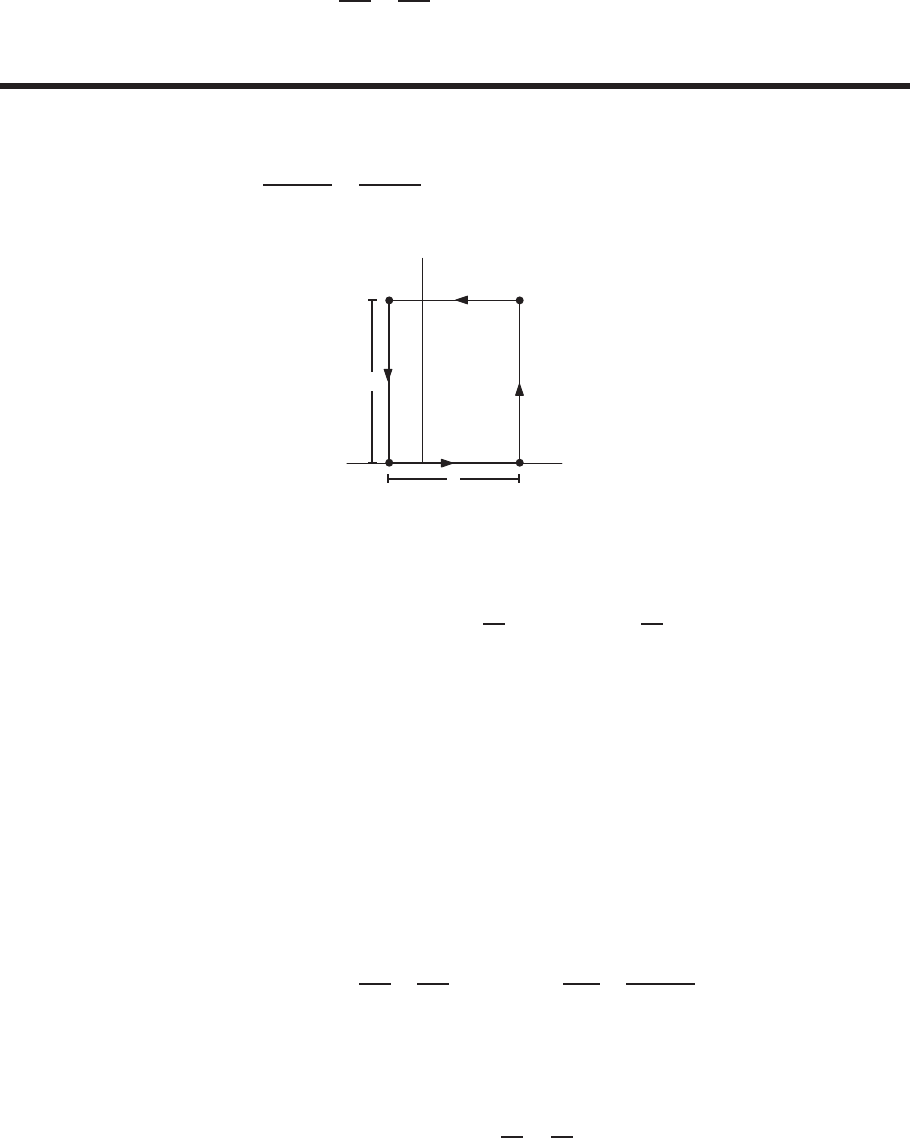
18.4 SOLUTIONS 1689
(b) Since ~
F=y~
i, we have ∂F1/∂y = 1 and ∂F2/∂x = 0 and ∂F1/∂y = 1. Thus, using Green’s Theorem if Ris
the region enclosed by the closed curve C(the unit circle centered at the origin and traversed counterclockwise), we
have ZC
~
F·d~r =ZR∂F2
∂x −∂F1
∂y dx dy =ZR
(−1) dx dy =−Area of R=−π.
Problems
18. The perimeter of the rectangle is a closed curve, C, so we can use Green’s Theorem. See Figure 18.25. The curve is
traversed in the correct direction to apply Green’s Theorem directly. Let Rbe the interior of the rectangle,
ZC
~
F·d~r =ZR∂(x+y)
∂x −∂(sin x)
∂y dxdy =ZR
1dxdy =Area of rectangle = 4 ·5 = 20.
(−1,0) (3,0)
(3,5)(−1,5)
✲✛ 4
✻
❄
5R
x
y
Figure 18.25
19. By Green’s Theorem, with Ras the interior of the square, we have
ZC
(sin(x2) cos y)
~
i+ (sin(y2) + ex)~
j·d~r =ZR∂
∂x (sin(y2) + ex)−∂
∂y (sin(x2) + cos y)dA
=Z1
0Z1
0
(ex+sin y)dx dy
=Z1
0
(ex+xsin y)
1
0
dy
=Z1
0
(e+ sin y)−1) dy
= (ey −cos y−y)
1
0
=e−cos 1 −1 + cos 0 = e−cos 1.
20. The curve is closed, so we can use Green’s Theorem. If Rrepresents the interior of the region
ZC
~
F·d~r =ZR∂F2
∂x −∂F1
∂y dA =ZR∂(x)
∂x −∂(x−y)
∂y dA
=ZR
(1 −(−1)) dA =ZR
2dA = 2 ·Area of sector.
Since Ris 1/8of a circle, Rhas area π(32)/8. Thus,
ZC
~
F·d~r = 2 ·9π
8=9π
4.

1690 Chapter Eighteen /SOLUTIONS
21. The curve is closed, so we can use Green’s Theorem. If Rrepresents the interior of the region
ZC
~
F·d~r =ZR∂F2
∂x −∂F1
∂y dA =ZR∂(sin y)
∂x −∂(x+y)
∂y dA
=ZR
(−1) dA = (−1) ·Area of sector.
Since Ris 1/8of a circle, Rhas area π(32)/8. Thus,
ZC
~
F·d~r = (−1) ·9π
8=−9π
8.
22. (a) Since ~
F= grad(x2ey), the Fundamental Theorem of Line Integrals gives
ZC
~
F·d~r =x2ey
(2,4)
(0,0)
= 4e4.
(b) Since
∂G2
∂x −∂G1
∂y =∂
∂x (x+y)−∂
∂y (x−y) = 2,
we know that ~
Gis not a gradient field. Parameterizing Cby x(t) = t, y(t) = 2tfor 0≤t≤2, we have
~r ′(t) = ~
i+ 2~
j, so
ZC
~
G·d~r =Z2
0
((t−2t)
~
i+ (t+ 2t)~
j)·(
~
i+ 2~
j)dt
=Z2
0
((t−2t) + (2t+ 4t)) dt =Z2
0
5t dt =5
2t2
2
0
= 10.
23. (a) By symmetry between quadrants II and IV, this integral is zero. To confirm, we can parameterize. This line is given
by
~r = (−~
i+~
j) + t(2
~
i−2~
j) = (−1 + 2t)
~
i+ (1 −2t)~
jfor 0≤t≤1.
Then ~r ′(t) = 2
~
i−2~
j, so
ZC
~
F·d~r =Z1
0(1 −2t)
~
i+ (−1 + 2t)~
j·(2
~
i−2~
j)dt =Z1
0
(4−8t)dt = 0.
(b) The curve Cis closed, so we use Green’s Theorem:
ZC
~
F·d~r =ZR∂
∂x (x)−∂
∂y (y)dA =ZR
0dA = 0.
(c) Since C=C2−C1, we have
ZC
~
F·d~r =ZC2
~
F·d~r −ZC1
~
F·d~r
0 = ZC2
~
F·d~r −0.
So ZC2
~
F·d~r = 0.
(d) The magnitude of ~
Gis constant on C2:
||~
G|| =p(3y)2+ (−3x)2= 3py2+x2= 3√2.
Thus, since Gis everywhere tangent to C2and points in the opposite direction to C2, we have
ZC2
~
G·d~r =−||~
G|| · Length of C2=−(3√2)π√2 = −6π.
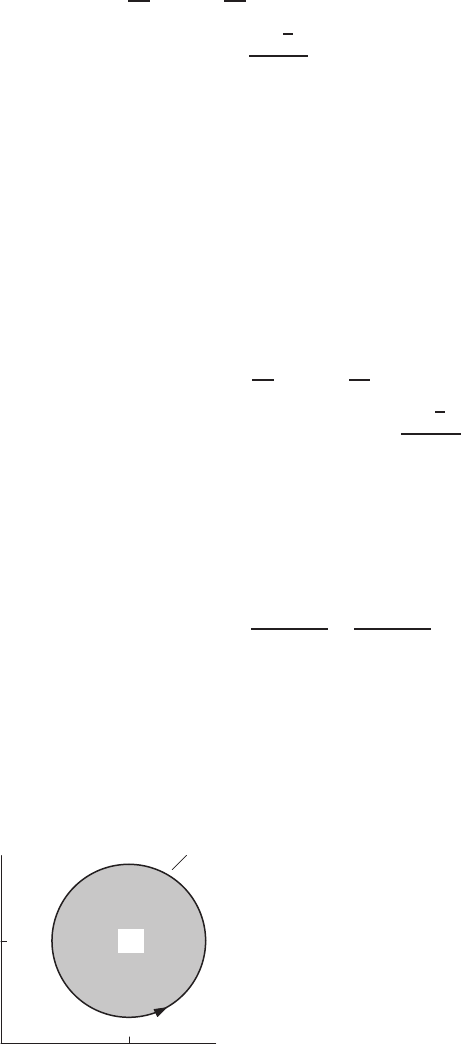
18.4 SOLUTIONS 1691
(e) The curve Cis closed, so we use Green’s Theorem:
ZC
~
G·d~r =ZR∂
∂x (−3x)−∂
∂y (3y)dA =ZR
(−6) dA
=−6·Area of R=−6π(√2)2
2=−6π.
(f) Since C=C2−C1, we have
ZC
~
G·d~r =ZC2
~
G·d~r −ZC1
~
G·d~r
−6π=−6π−ZC1
~
G·d~r .
Hence, ZC1
~
G·d~r = 0.
(g) The curve Cis closed, so we use Green’s Theorem:
ZC
(~
F+~
G)·d~r =ZC
(4y~
i−2x~
j)·d~r =ZR
∂
∂x (−2x)−∂
∂y (4y)dA =ZR−6dA
=−6·Area of R=−6·π(√2)2
2=−6π.
Alternately, ZC
(~
F+~
G)·d~r =ZC
~
F·d~r +ZC
~
G·d~r = 0 −6π=−6π.
24. (a) The curve, C, is closed and oriented in the correct direction for Green’s Theorem. See Figure 18.26. Writing Rfor
the interior of the circle, we have
ZC(x2−y)
~
i+(y2+x)~
j·d~r =ZR∂(y2+x)
∂x −∂(x2−y)
∂y dxdy
=ZR
(1−(−1)) dxdy = 2 ZR
dxdy
= 2 ·Area of circle = 2(π·32) = 18π.
(b) The circle given has radius Rand center (a, b). The argument in part (a) works for any circle of radius R, oriented
counterclockwise. So the line integral has the value 2πR2.
5
4R C
✠(x−5)2+ (y−4)2= 9
x
y
Figure 18.26
1692 Chapter Eighteen /SOLUTIONS
25. (a) The particle moving along C1starts at the origin and moves simultaneously radially outward and counterclockwise in
the xz-plane, describing a spiral. The spiral completes two full revolutions around the origin, starting at (0,0,0) and
ending at the point (2,0,0). The particle moving along C2starts at the origin and moves simultaneously outward,
counterclockwise, and forward along the positive y-axis, describing a 3-dimensional spiral coil growing in diameter
as it wraps around the y-axis. The coil completes two full revolutions around the y-axis, starting at (0,0,0) and
ending at the point (2,2,0).
(b) We suspect ~
Fis a gradient field and look for a potential function f. We have:
f(x, y, z) = Zfxdx=Zyz dx =yzx +g(y, z).
We now have two expressions for fy, which we set equal to each other:
z(x+ 1) = fy=zx +gy.
This means
zx +z=zx +gy,or gy=z.
Thus,
g(y, z) = Zgydy=Zz dy =zy +h(z),
and also
f(x, y, z) = yzx +zy +h(z).
Lastly, we set both expressions for fzequal to each other
xy +y+ 1 = fz=yx +y+h′(z).
This means h(z) = zwhich gives us
f(x, y, z) = xyz +zy +z.
Thus, ~
F=∇fand we can calculate the line integral using the Fundamental Theorem of Calculus for Line Integrals:
ZC2
~
F·dr=f(2,2,0) −f(0,0,0) = 0 −0 = 0.
(c) The beginning points and the endpoints of C1and C2, respectively, have identical z-values. Since this common z-
value is zero, we may look for a gradient field ~
Gwhose potential function has a factor of z, then use the Fundamental
Theorem of Calculus for Line Integrals to calculate both integrals. Note that
~
G=~
F=∇(xyz +zy +z)and
~
G=∇(ze−xyz)
both work, for example. In each case we have:
ZC1
~
G·dr=ZC2
~
G·dr = 0.
There are many other possible answers.
(d) Reasoning as in (c) above, we choose
~
H1=~
F=∇(xyz +zy +z)and
~
H2=∇(ze−xyz),
for example. These fields work because, using the Fundamental Theorem of Calculus for Line Integrals, we get
ZC1
~
H1·d~r =ZC1
~
H2·d~r = 0.
The fields
~
H1=∇(yx2)and
~
H2=∇(y(x+z))
also work, since y= 0 at the beginning and endpoints of C1and the Fundamental Theorem of Calculus for Line
Integrals yields: ZC1
~
H1·d~r =ZC1
~
H2·d~r = 0.
There are many other possible answers, and not all of them yield a zero value for the integrals.
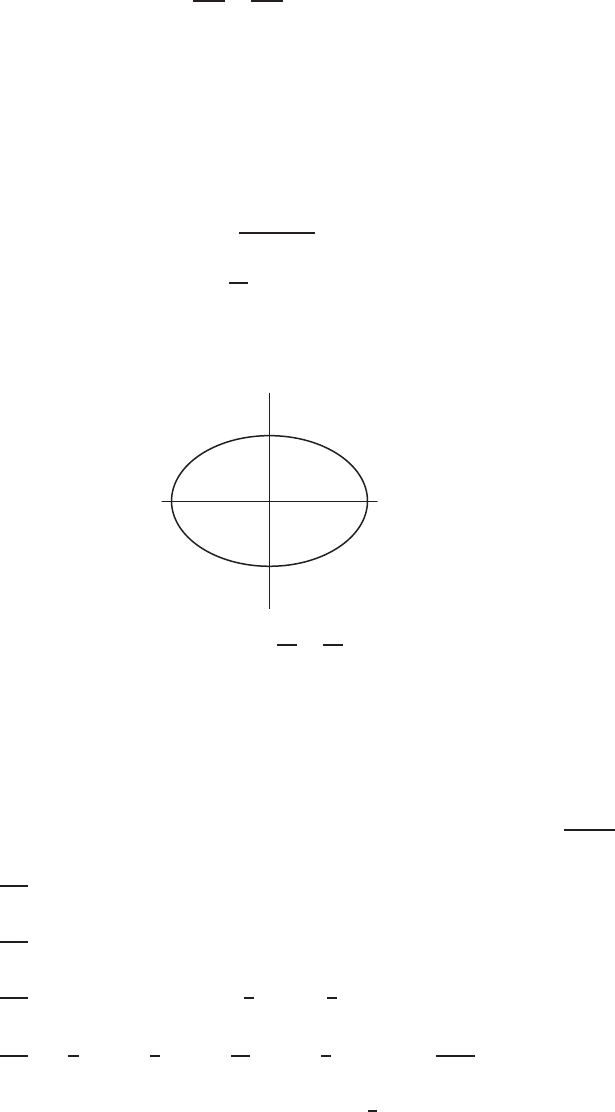
18.4 SOLUTIONS 1693
26. Since ~
F=x~
j, we have ∂F2/∂x = 1 and ∂F1/∂y = 0.Thus, using Green’s Theorem if Ris the region enclosed by the
closed curve C, we have
ZC
~
F·d~r =ZR∂F2
∂x −∂F1
∂y dx dy =ZR
1dx dy =Area of R
27. Using ~
F=x~
j=acos t~
jand ~r ′(t) = −asin t
~
i+bcos t~
j, we have
A=ZC
~
F·d~r =Z2π
0
(acos t)(bcos t)dt
=ab Z2π
0
cos2t dt
=ab Z2π
0
1 + cos 2t
2dt
=πab +ab
4sin 2t2π
0=πab
The ellipse is shown in Figure 18.27.
a
b
x
y
Figure 18.27
:x2
a2+y2
b2= 1
28. Using ~
F=x~
j=acos3tand ~r ′(t) = −3acos2tsin t
~
i+ 3asin2tcos t~
j, we have
A=ZC
~
F·d~r =Z2π
0
(acos3t)(3asin2tcos t)dt
= 3a2Z2π
0
cos4tsin2t dt = 3a2Z2π
0
cos2t(sin tcos t)2dt = 3a2Z2π
0
cos2tsin22t
4dt
=3a2
16 Z2π
0
(1 + cos 2t)(1 −cos 4t)dt
=3a2
16 Z2π
0
(1 + cos 2t−cos 4t−cos 2tcos 4t)dt
=3a2
16 Z2π
0
(1 + cos 2t−cos 4t−1
2cos 6t−1
2cos 2t)dt
=3a2
16 (t−1
2sin 2t−1
4sin 4t+1
12 sin 6t+1
4sin 2t)
2π
0
=3πa2
8
For the last integral we use the trigonometric formula cos 2tcos 4t=1
2(cos 6t+ cos 2t).
The hypocycloid is shown in Figure 18.28.
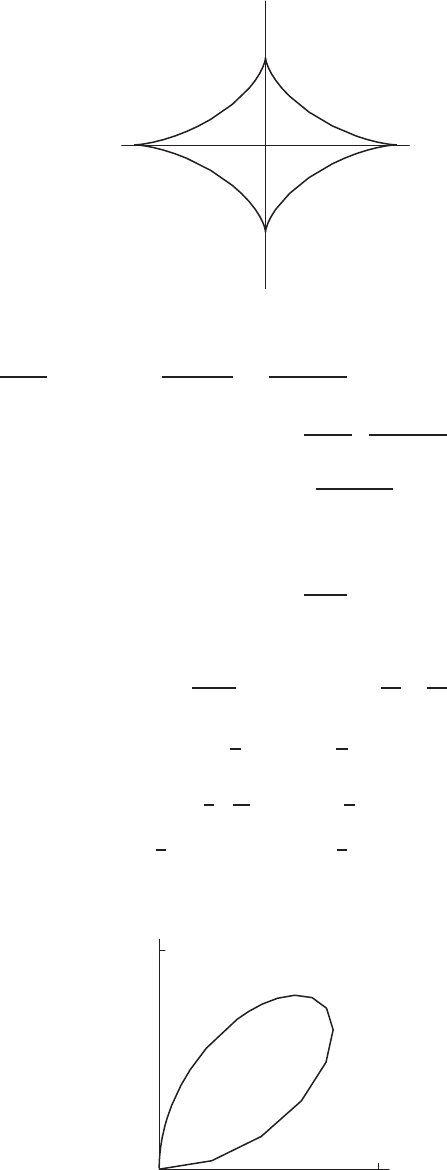
1694 Chapter Eighteen /SOLUTIONS
a
a
x
y
Figure 18.28
:x2/3+y2/3=a2/3
29. Using ~
F=x~
j=3t2
1 + t3~
jand ~r ′(t) = 1−2t3
(1 + t3)2~
i+3t(2 −t3)
(1 + t3)2~
j, we have
A=ZC
~
F·d~r =Z∞
0
3t
1 + t3·3t(2 −t3)
(1 + t3)2dt
= 9 Z∞
0
t2(2−t3)
(1 + t3)3dt
We make the change of variables u= 1 + t3so du = 3t2dt and 2−t3= 3 −u. So
A= 3 Z∞
1
3−u
u3du.
This is an improper integral, so it can be computed as follows
A= 3 Z∞
1
3−u
u3du = lim
b→∞ 3Zb
13
u3−1
u2du
= lim
b→∞ "9−1
2u−2
b
1
+31
u
b
1#
= lim
b→∞ h−9
21
b2−1+ 3 1
b−1i
=−9
2(0 −1) + 3(0 −1) = 3
2.
The Folium of Descartes is shown in Figure 18.29.
2
2
x
y
Figure 18.29
:x3+y3= 3xy

18.4 SOLUTIONS 1695
30. Suppose Cencloses a region R. Then, using Green’s Theorem, we have
ZC
~
F·d~r =ZR∂F2
∂x −∂F1
∂y dA
=ZR
∂
∂x (4x(1 −y2) + xsin(xy)) −∂
∂y (−y3+ysin(xy)) dA
=ZR
4(1 −y2) + sin(xy) + xy cos(xy) + 3y2−sin(xy)−xy cos(xy)dA
=ZR
(4−y2)dA
This integral over Ris largest if Cencloses the maximum possible region where 4−y2>0, that is, where −2≤y≤2.
Therefore Cshould be the curve with two sides along the lines y=−2and y= 2, as well as two arcs of the circle
x2+y2= 25. See Figure 18.30.
−2
2
5
−5
y
x
x2+y2= 25
Figure 18.30
31. Since the level curves must be perpendicular to the gradient vectors, if there were a contour diagram fitting this gradient
field, it would have to look like Figure 18.31. However, this diagram could not be the contour diagram because the origin
is on all contours. This means that f(0,0) would have to take on more than one value, which is impossible. At a point P
other than the origin, we have the same problem. The values on the contours increase as you go counterclockwise around,
since the gradient vector points in the direction of greatest increase of a function. But, starting at P, and going all the way
around the origin, you would eventually get back to Pagain, and with a larger value of f, which is impossible.
An additional problem arises from the fact that the vectors in the original vector field are longer as you go away from
the origin. This means that if there were a potential function fthen ||grad f|| would increase as you went away from the
origin. This would mean that the level curves of fwould get closer together as you go outward which does not happen in
the contour diagram in Figure 18.31.
x
y
Figure 18.31
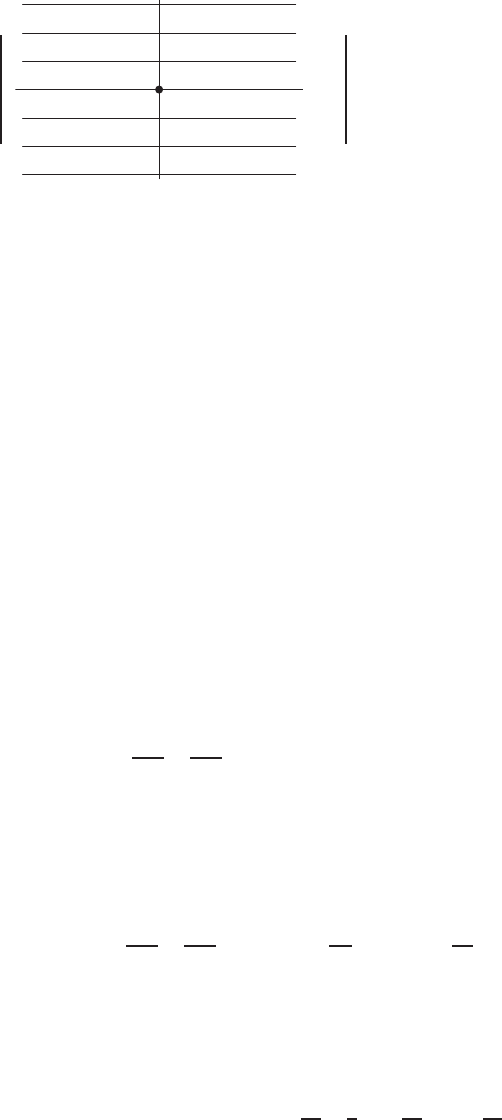
1696 Chapter Eighteen /SOLUTIONS
32. The drawing of the contour diagrams in Figure 18.32 fitting this gradient field would look like Figure 18.32. The values
on the contours would increase both as yincreases (for positive x) and as ydecreases (for negative x), following the rule
that the gradient vector points in the direction of greatest increase of a function. Therefore, it is impossible for this to be a
contour diagram.
x
y
o
❄
✻
Increasing
f
-values
Increasing
f
-values
Figure 18.32
33. (a) We see that ~
F , ~
G , ~
Hare all gradient vector fields, since
grad(xy) = ~
Ffor all x, y
grad(arctan(x/y)) = ~
Gexcept where y= 0
grad (x2+y2)1/2=~
Hexcept at (0,0).
Other answer are possible. For example grad(−arctan(y/x)) = ~
Gfor x6= 0.
(b) Parameterizing the unit circle, C, by x= cos t,y= sin t,0≤t≤π, we have ~r ′(t) = −sin t
~
i+ cos t~
j, so
ZC
~
F·d~r =Z2π
0
((sin t)
~
i+ (cos t)~
j)·((−sin t)
~
i+ (cos t)~
j)dt =Z2π
0
cos(2t)dt = 0.
The vector field ~
Gis tangent to the circle, pointing in the opposite direction to the parameterization, and of length 1
everywhere. Thus ZC
~
G·d~r =−1·Length of circle =−2π.
The vector field ~
Hpoints radially outward, so it is perpendicular to the circle everywhere. Thus
ZC
~
H·d~r = 0.
(c) Green’s Theorem does not apply to the computation of the line integrals for ~
Gand ~
Hbecause their domains do not
include the origin, which is in the interior, R, of the circle. Green’s Theorem does apply to ~
F=y~
i+x~
j.
ZC
~
F·d~r =ZR∂F2
∂x −∂F1
∂y dx dy =Z0dx dy = 0.
34. (a) I Green’s Theorem can be used. The curve is closed and the vector field is smooth throughout the interior of the
region enclosed
II Green’s Theorem cannot be used. The vector field is not defined at the origin which is inside the curve.
III Green’s Theorem cannot be used. The curve is not closed.
(b) For the integral in [I], let Rbe the region enclosed by C. See Figure 18.33. Green’s Theorem gives
ZC
(x2+y2)dx+ (x2+y2)dy =ZR∂F2
∂x −∂F1
∂y dA =ZR∂
∂x (x2+y2)−∂
∂y (x2+y2)dA
=ZR
(2x−2y)dA =Z1
0Zx
x2
(2x−2y)dy dx
=Z1
0
(2xy −y2)
x
x2
dx =Z1
0
(2x2−x2−(2x3−x4)) dx
=Z1
0
(x2−2x3+x4)dx =x3
3−2
4x4+x5
5
1
0
=1
30 .

18.4 SOLUTIONS 1697
1
1
y=x
y=x2
x
y
Figure 18.33
35. Green’s theorem says that for a closed curve Coriented counterclockwise, bounding region R,
ZC
~
F·d~r =ZR∂F2
∂x −∂F1
∂y dA =ZR
(x2+y2−1) dA.
If Ris a region contained strictly inside the unit circle, then x2+y2<1for any point (x, y)in R, so x2+y2−1<0,
which gives ZR
(x2+y2−1)dA < 0, which implies that ZC
~
F·d~r < 0.
Now, let Cbe the curve C1−C2. Since
ZC
~
F·d~r =ZC1−C2
~
F·d~r =ZC1
~
F·d~r −ZC2
~
F·d~r =L1−L2<0,
we have L1< L2. Similarly, if we let C=C2−C3, then
ZC
~
F·d~r =ZC2
~
F·d~r −ZC3
~
F·d~r =L2−L3<0,
which gives L2< L3. Thus
L1< L2< L3.
36. (a) Writing R1for the interior of the circle, Green’s Theorem gives
ZC1
~
F·d~r =ZR1∂F2
∂x −∂F1
∂y dA =ZS
3dA= 3 ·Area of disk = 3 ·π12= 3π.
(b) Writing R2as the interior of the rectangle, Green’s Theorem gives
ZC2
~
F·d~r =ZR2
3dA = 3 ·Area of rectangle = 3 ·3·2 = 18.
(c) In parts (a) and (b), we see that the line integral is three times the area enclosed in the curve. Since C3encloses a disk
of radius 7 and area π·72= 153.9, and C4encloses a disk of radius 8 and area π·82= 201.1, and C5encloses a
square of side 14 and area 142= 196, we have
ZC3
~
F·d~r < ZC5
~
F·d~r < ZC4
~
F·d~r .

1698 Chapter Eighteen /SOLUTIONS
37. (a) We use Green’s Theorem. Let Rbe the region enclosed by the circle C. Then
ZC
~
F·d~r =ZR∂F2
∂x −∂F1
∂y dA =ZR∂
∂x (ey2+ 12x)−∂
∂y (3x2y+y3+ex)dA
=ZR
(12 −(3x2+ 3y2)dA =ZR
(12 −3(x2+y2)) dA.
Converting to polar coordinates, we have
ZC
~
F·d~r =Z2π
0Z1
0
(12 −3r2)r dr dθ = 2π6r2−3
4r4
1
0
=2π6−3
4=21π
2.
(b) The integrand of the integral over the disk Ris 12 −3(x2+y2). Since the integrand is positive for x2+y2<4and
negative for x2+y2>4, the integrand is positive inside the circle of radius 2 and negative outside that circle. Thus,
the integral over Rincreases with auntil a= 2 and then decreases. The maximum value of the line integral occurs
when a= 2.
38. (a) Taking partial derivatives using the product rule, we have
∂F2
∂x =∂
∂x x
x2+y2=1
x2+y2−x·2x
(x2+y2)2=y2−x2
(x2+y2)2.
Similarly,
∂F1
∂y =∂
∂y −y
x2+y2=−1
x2+y2+y·2y
(x2+y2)2=y2−x2
(x2+y2)2.
Thus,
curl of ~
F=∂F2
∂x −∂F1
∂y = 0.
(b) Let Cbe the clock-wise oriented closed path consisting of four pieces
•C1
•BD, the straight line path from Bto D
• −C2
•CA, the straight line path from Cto A.
By Green’s Theorem and part (a), ZC
~
F·d~r = 0.
Hence ZC1
~
F·d~r +ZBD
~
F·d~r −ZC2
~
F·d~r +ZCA
~
F·d~r = 0.
The key observation is that the vector field ~
Fis perpendicular to each of the radial paths BD and CA. To see
this, consider the radial vector field ~r =x
~
i+y~
jwhich is tangent to the paths BD and CA. Since
~r ·~
F= 0
the vector fields ~
Fand ~r are orthogonal.
Therefore, RBD ~
F·d~r =RCA ~
F·d~r = 0 and it follows that
ZC1
~
F·d~r =ZC2
~
F·d~r .
(c) Compute the integral over C2, which is on the unit circle. On the unit circle, ~
Fis tangent to the circle and ||~
F|| = 1.
Thus, ZC
~
F·d~r =||~
F|| · Length of curve = 1 ·θ=θ.
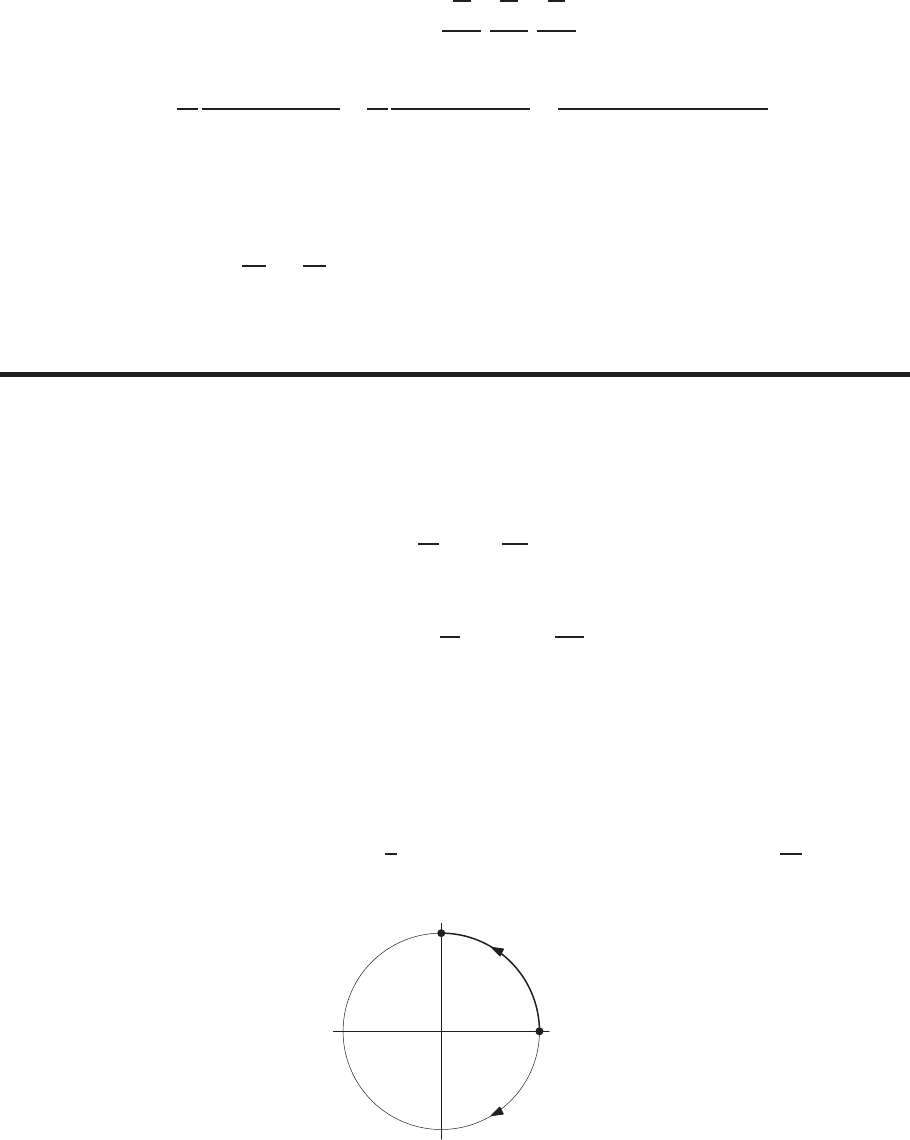
18.4 SOLUTIONS 1699
39. (a) We can show
curl ~
E=
~ı ~ ~
k
∂
∂x
∂
∂y
∂
∂z
qx
||~r ||3
qy
||~r ||3
qz
||~r ||3
=~
0.
Let’s check, for instance, the ~ı component of curl ~
E:
∂
∂y
qz
(x2+y2+z2)3/2−∂
∂z
qy
(x2+y2+z2)3/2=(−3/2)2qyz −(−3/2)2qzy
(x2+y2+z2)5/2= 0.
The vector field ~
Eis a gradient vector field, as curl ~
E= 0 and ~
Eis defined everywhere in 3-space except at the
origin. This domain satisfies the criteria for the curl test in 3-space. Every closed curve in 3-space which does not
pass through 0 bounds a surface not containing the origin.
(b) The function ϕ(~r ) = q/||~r || is a potential for ~
E, since
∂ϕ
∂x =q∂
∂x (x2+y2+z2)−1/2=−qx(x2+y2+z2)−3/2=−E1
and similarly for ∂ϕ/∂y and ∂ϕ/∂z; hence ~
E=−grad ϕ.
Strengthen Your Understanding
40. To conclude that ~
Fis path-independent, we must know that RC~
F·d~r = 0 for every closed path in the domain of ~
F. It
is not sufficient to check the equality for a single specific closed path.
41. Since Cis not a closed curve, Green’s Theorem does not apply. Calculating the line integral requires more information
about ~
F.
42. If ~
F=xy~
i+Q(x, y)~
jis a gradient field, then by the curl test we see that
∂
∂y (xy) = ∂Q
∂x .
Therefore, ∂Q/∂x =x. If Q(x, y) = x2/2, then
~
F=xy~
i+x2
2~
j= grad x2y
2.
43. Because the scalar curl of ~
Fis zero everywhere except at the origin, the vector field ~
Fis path independent in any region
that does not contain or encircle the origin. Let C1be the counterclockwise path on the unit circle from (1,0) to (0,1)
and let C2be the clockwise path on the unit circle from (1,0) to (0,1). See Figure 18.34.
The paths C1and C2are not both contained in a single region of the plane that does not contain or encircle the origin,
so it is possible that the line integrals of ~
Fover C1and C2are not equal. Since ~
Fis tangent to the unit circle, points
counterclockwise, and ||~
F|| = 1, we have
ZC1
~
F·d~r = 1 ·Length C1=π
2and ZC2
~
F·d~r =−1·Length C2=−3π
2.
C1
C2
(0,1)
(1,0)
x
y
Figure 18.34
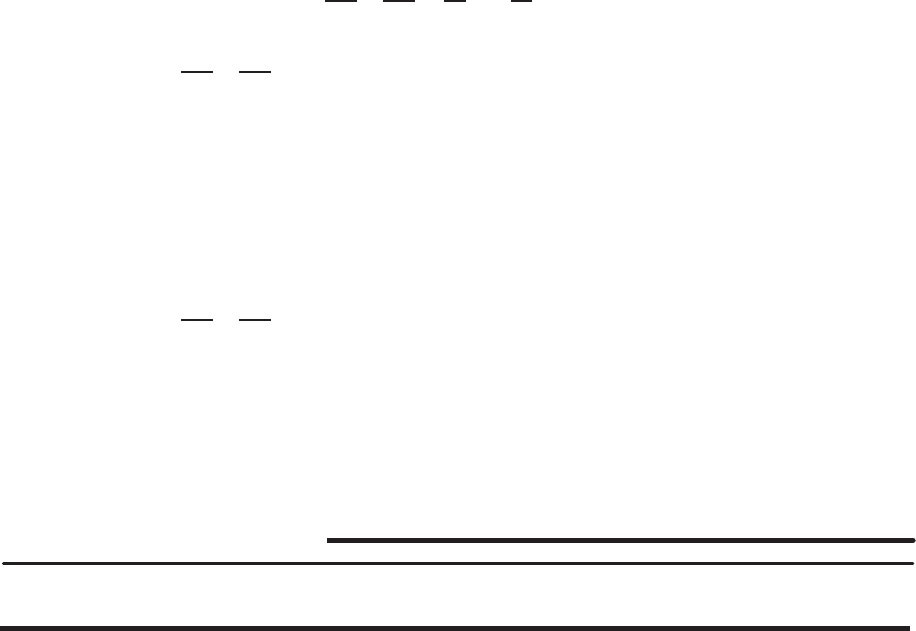
1700 Chapter Eighteen /SOLUTIONS
44. The vector field ~
F=x
~
i+x2~
jis not a gradient field because its scalar curl is not zero:
∂F2
∂x −∂F1
∂y =∂
∂x x2−∂
∂y x= 2x6= 0.
45. True. The value of ∂F2
∂x −∂F1
∂y is 0−0 = 0, so the field is path-independent.
46. False. The fact that ~
F= grad fmeans that ~
Fis a potential field, hence ~
Fis path-independent. Thus RC~
F·d~r = 0
since Cis closed.
47. True. Since ~
Fand ~
Gare both path-independent, we know ~
F= grad fand ~
G= grad gfor some scalar functions f
and g. Then grad(f+g) = grad f+ grad g=~
F+~
G, so ~
F+~
Gis a gradient field, hence path-independent.
48. False. As a counterexample, consider ~
F=x~
jand ~
G=y~
i . Then both of these are path-dependent (they each have
nonzero curl), but the curl of ~
F+~
G=y~
i+x~
jis zero everywhere, so ~
F+~
Gis path-independent.
49. True. This vector field has components F1=x, F2=y, and F3=z. Using the 3-space curl test gives zero for all of the
components of curl ~
F , so the field is path-independent.
50. True. The value of ∂F2
∂x −∂F1
∂y is 0−0 = 0, so the field is path-independent.
51. True. Since ~
Fis path-independent, we know ~
F= grad ffor some scalar function f. Then grad(kf ) = kgrad f=k~
F ,
so k~
Fis a gradient field, hence path-independent.
52. False. As a counterexample, consider the vector field ~
F= 2x
~
i, which is path-independent, since it is the gradient of
f(x, y) = x2.Multiplying ~
Fby the function h(x, y) = ygives the field y~
F= 2xy~
i. The curl of this vector field is
−2x6= 0, so y~
Fis path-dependent.
Solutions for Chapter 18 Review
Exercises
1. On the top half of the circle, the angle between the vector field and the curve is less than 90◦, so the line integral is positive.
On the bottom half of the circle, the angle is more than 90◦, so the line integral is negative. However the magnitude of the
vector field is larger on the top half of the curve, so the positive contribution to the line integral is larger than the negative.
Thus the line integral RC~
F·d~r is positive.
2. The angle between the vector field and the curve is more than 90◦at all points on C, so the line integral is negative.
3. (a) The line integral around Ais zero, because the curve is perpendicular to the field everywhere.
(b) The line integral along C1or C3is zero because the curves are everywhere perpendicular to the vector field. Along
C2, the line integral is negative, since ~
Fpoints along the opposite direction to the curve. Along C4, the line integral
is positive, since ~
Fpoints in the same direction as the curve.
(c) The line integral around Cis zero because C1and C3are perpendicular to the field and the contributions from C2
and C4cancel out.
4. (a) The line integral around Ais negative, because the vectors of the field are all pointing in the opposite direction to the
direction of the path.
(b) Along C1, the line integral is positive, since ~
Fpoints in the same direction as the curve. Along C2or C4, the line
integral is zero, since ~
Fis perpendicular to the curve everywhere. Along C3, the line integral is negative, since ~
F
points in the opposite direction to the curve.
(c) The line integral around Cis negative because C3is longer than C1and the magnitude of the field is bigger along
C3than C1.
5. Scalar. The displacement along the line from (5,2) to (1,8) is given by −4
~
i+ 6~
j, so
ZC
(3
~
i+ 4~
j)·d~r = (3
~
i+ 4~
j)·(−4
~
i+ 6~
j) = 12.
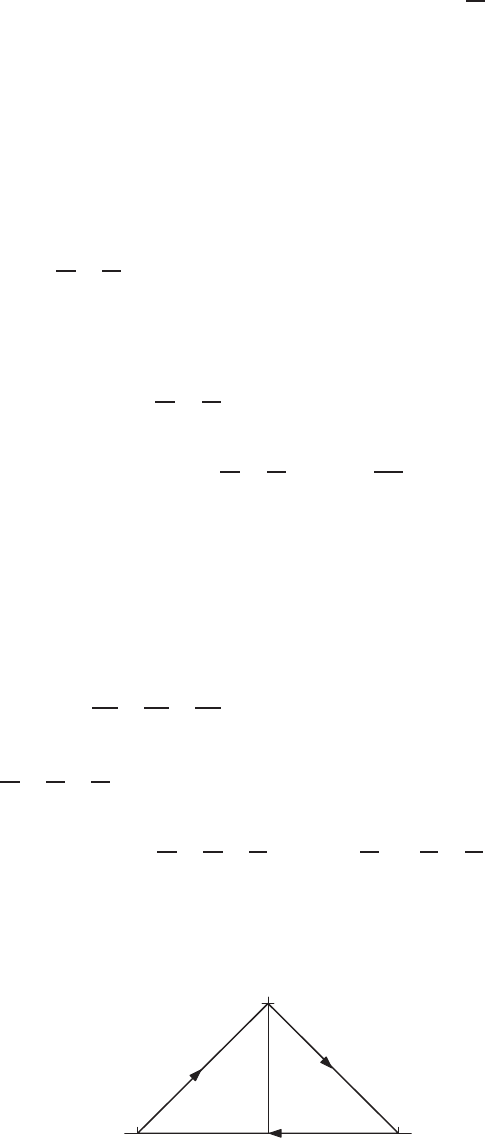
SOLUTIONS to Review Problems for Chapter Eighteen 1701
6. Scalar. Since the path is along the y-axis, the~
icomponent does not contribute to the line integral. On the path, d~r =~
j dy,
so ZC
(x
~
i+x~
j)·d~r =Z6
2
(x
~
i+y~
j)·~
jdy =Z6
2
y dy =y2
2
6
2
=16.
7. Since ~
F=6
~
i−7~
j, consider the function f
f(x, y) = 6x−7y.
Then we see that grad f= 6
~
i−7~
j, so we use the Fundamental Theorem of Calculus for Line Integrals:
ZC
~
F·d~r =ZC
grad f·d~r
=f(4,4) −f(2,−6) = (−4) −(54) = −58.
8. We know that if f(x, y) = x2
2+y2
2, then grad f=x
~
i+y~
j=~
F. Thus,
ZC
~
F·d~r = 0.
9. Since ~
Fis a gradient field, ~
F= grad x2
2+y2
2, we have
ZC
~
F·d~r =x2
2+y2
2
(0,10)
(0,0)
=100
2−0 = 50.
10. We can parameterize the curve Cby (t, t2+ 1),for 0≤t≤1.Then
ZC
~
F·d~r =Z1
0
~
F(t, t2+ 1) ·(
~
i+ 2t~
j)dt =Z1
0
((−1)
~
i+ (t4+ 2t2+t+ 1)~
j)·(
~
i+ 2t~
j)dt
=Z1
0
(−1 + 2t(t4+ 2t2+t+ 1))dt =Z1
0
(−1 + 2t5+ 4t3+ 2t2+ 2t)dt
=−t+2t6
6+4t4
4+2t3
3+t2
1
0
= 2
11. Since ~
F= grad x2
2+y2
2+z2
2, the Fundamental Theorem of Line Integrals gives
ZC
~
F·d~r =x2
2+y2
2+z2
2
(0,0,7)
(2,3,0)
=72
2−22
2+32
2= 18.
12. The path can be broken into three line segments: C1, from (1,0) to (−1,0), and C2, from (−1,0) to (0,1), and C3, from
(0,1) to (1,0). (See Figure 18.35.)
(−1,0) (1,0)
(0,1)
C1
C2C3
x
y
Figure 18.35
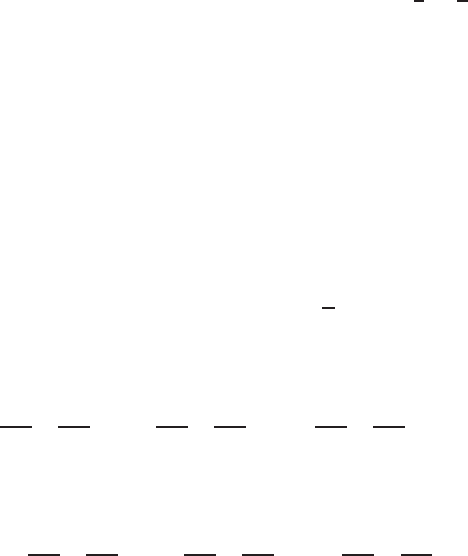
1702 Chapter Eighteen /SOLUTIONS
Along C1we have y= 0 so the vector field xy~
i+ (x−y)~
jis perpendicular to C1; Thus, the line integral along
C1is 0.
C2can be parameterized by (−1 + t, t), for 0≤t≤1so the integral is
ZC2
~
F·d~r =Z1
0
~
F(−1 + t, t)·(
~
i+~
j)dt
=Z1
0
[t(−1 + t)
~
i+ (−1)~
j]·(
~
i+~
j)dt
=Z1
0
(−t+t2−1) dt
= (−t2/2 + t3/3−t)1
0
=−1/2+ 1/3−1−(0 + 0 + 0) = −7/6
C3can be parameterized by (t, 1−t), for 0≤t≤1so the integral is
ZC3
~
F·d~r =Z1
0
~
F(t, 1−t)·(
~
i−~
j)dt
=Z1
0
(t(1 −t)
~
i+ (2t−1)~
j)·(
~
i−~
j)dt
=Z1
0
(−t2−t+1) dt
= (−t3/3−t2/2 + t)1
0
=−1/3−1/2 + 1 −(0 + 0 + 0) = 1/6
So the total line integral is
ZC
~
F·d~r =ZC1
~
F·d~r +ZC2
~
F·d~r +ZC3
~
F·d~r = 0 + (−7
6) + 1
6=−1
13. Using xas the parameter we have dy = 2xdx. Thus
ZC
3x2dx+ 4ydy =Z5
1
3x2dx + 4x2(2xdx) = Z5
1
x2+ 8x3dx =x3+ 2x4
5
1
= 1372.
14. Using xas the parameter we have dy = cos x dx. Thus
ZC
ydx +xdy =Zπ/2
0
sin x dx +x(cos x dx) = Zπ/2
0
sin x+xcos x dx
=−cos x+ cos x+xsin x
π/2
0
=π
2.
15. The domain is all 3-space. Since F1=y,
curl y~
i=∂F3
∂y −∂F2
∂z ~
i+∂F1
∂z −∂F3
∂x ~
j+∂F2
∂x −∂F1
∂y ~
k=−~
k6=~
0,
so ~
Fis not path-independent.
16. The domain is all 3-space. Since F2=y,
curl y~
j=∂F3
∂y −∂F2
∂z ~
i+∂F1
∂z −∂F3
∂x ~
j+∂F2
∂x −∂F1
∂y ~
k=~
0,
so ~
Fis path-independent.
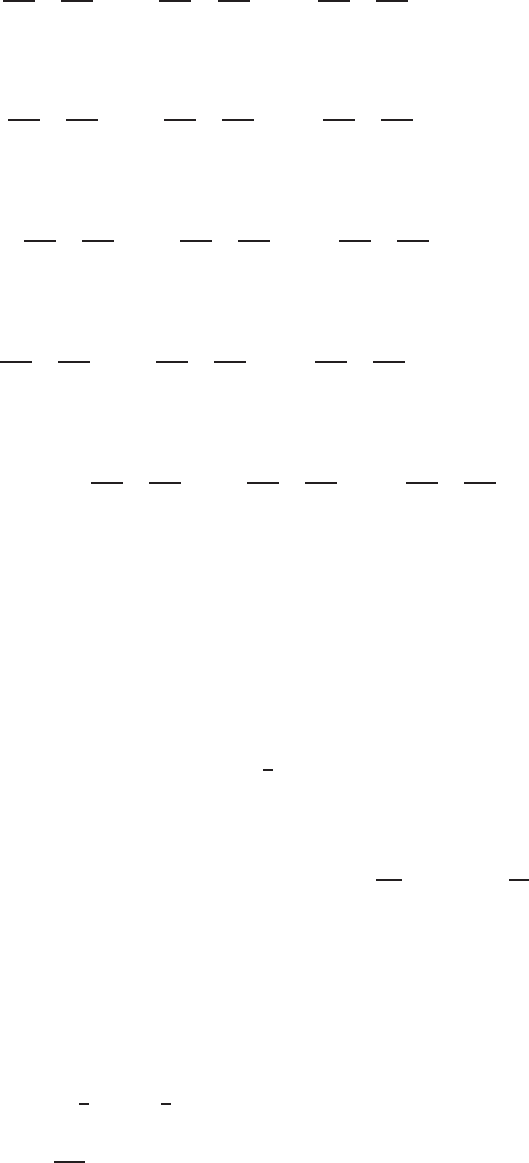
SOLUTIONS to Review Problems for Chapter Eighteen 1703
17. The domain is all 3-space. Since F3=z,
curl z~
k=∂F3
∂y −∂F2
∂z ~
i+∂F1
∂z −∂F3
∂x ~
j+∂F2
∂x −∂F1
∂y ~
k=~
0,
so ~
Fis path-independent.
18. Since F2=F3=z,
curl (z~
j+z~
k) = ∂F3
∂y −∂F2
∂z ~
i+∂F1
∂z −∂F3
∂x ~
j+∂F2
∂x −∂F1
∂y ~
k=−~
i6=~
0,
so ~
Fis not path-independent.
19. The domain is all 3-space. Since F1=y,F2=x,
curl y~
i+x~
j=∂F3
∂y −∂F2
∂z ~
i+∂F1
∂z −∂F3
∂x ~
j+∂F2
∂x −∂F1
∂y ~
k=~
0,
so ~
Fis path-independent
20. The domain is all 3-space. Since F1=x+y,
curl (x+y)~
i=∂F3
∂y −∂F2
∂z ~
i+∂F1
∂z −∂F3
∂x ~
j+∂F2
∂x −∂F1
∂y ~
k=−~
k6=~
0,
so ~
Fis not path-independent.
21. The domain is all 3-space. Since F1=yz,F2=zx,F3=xy,
curl (yz~
i+zx~
j+xy~
k) = ∂F3
∂y −∂F2
∂z ~
i+∂F1
∂z −∂F3
∂x ~
j+∂F2
∂x −∂F1
∂y ~
k
= (x−x)
~
i+ (y−y)~
j+ (z−z)~
k=~
0,
so ~
Fis path-independent.
22. Since the line is parallel to the y-axis, only the ~
j-component contributes to the line integral. On C, we have x= 2, so
~
F= 10
~
i+ 6~
jand d~r =~
j dy. Thus,
ZC
~
F·d~r =Z8
3
6~
j·~
j dy = 6 ·5 = 30.
23. Since the line is parallel to the x-axis, only the~
i-component contributes to the line integral. On C, we have d~r =~
i dx,
so
ZC
~
F·d~r =Z12
2
5x
~
i·~
i dx =5
2x2
12
2
= 350.
24. Parameterizing Cby x(t) = t,y(t) = t2, with 1≤t≤2, we have ~r ′(t) = ~
i+ 2t~
j. Thus,
ZC
~
F·d~r =Z2
1
(5t
~
i+ 3t~
j)·(
~
i+ 2t~
j)dt =Z2
1
(5t+ 6t2)dt =5t2
2+ 2t3
2
1
=43
2.
25. Parameterizing Cby x(t) = 3 cos t,y= 3 sin t, with 0≤t≤π, we have ~r ′(t) = −(3 sin t)
~
i+ (3 cos t)~
j. Thus,
ZC
~
F·d~r =Zπ
0
(15 cos t
~
i+ 9 cos t~
j)·(−3 sin t
~
i+ 3 cos t~
j)dt
= 9 Zπ
0
(−5 cos tsin t+ 3 cos2t)dt
= 9 5
2cos2t+3
2(cos tsin t+t)
π
0
=27π
2.
The integral Rcos2twas calculated using Formula IV-18.

1704 Chapter Eighteen /SOLUTIONS
26. We use Green’s Theorem:
ZC
~
F·d~r =ZC
(5x
~
i+ 3x~
j)·d~r =ZR∂(3x)
∂x −∂(5x)
∂y dx dy
=ZR
3dx dy = 3 ·Area of region = 3(3 ·2 + 1
23·3) = 63
2.
27. We can calculate this line integral either by calculating a separate line integral for each side, or by adding a line segment,
C1, from (1,4) to (1,1) to form the closed curve C+C1. Since we now have a closed curve, we can use Green’s Theorem:
ZC+C1
~
F·d~r =ZC+C1
(5x
~
i+ 3x~
j)·d~r =ZR∂
∂x (3x)−∂
∂y (5y)dx dy
=ZR
3dx dy = 3 ·Area of region = 3 2·3 + 1
23·4= 36.
Since d~r =−~
j dy on C1, we have
ZC1
~
F·d~r =Z1
4
3·1~
j·(−~
j dy) = −3·3 = −9.
Since ZC+C1
~
F·d~r =ZC
~
F·d~r +ZC1
~
F·d~r =ZC
~
F·d~r −9 = 36
we have ZC
~
F·d~r = 45.
28. Since ~
F= grad(5x+ 4y), we have
ZC1
~
F·d~r = 0
ZC2
~
F·d~r = (5x+ 4y)
(7,4)
(3,4)
= (5 ·7 + 4 ·4) −(5 ·3 + 4 ·4) = 20.
29. Since ~
F= grad 5
2x2+ 2y2, we have
ZC1
~
F·d~r = 0
ZC2
~
F·d~r =5
2x2+ 2y2
(7,4)
(3,4)
=5
2·72+ 2 ·42−5
2·32+ 2 ·42= 100.
30. Since ~
Fis not a gradient vector field, and
∂
∂x (4x)−∂
∂y (5y) = 4 −5 = −1,
we find the line integral around C1by Green’s Theorem. The path C1is oriented clockwise, so with R1as the disk inside
C1, we have ZC1
~
F·d~x =−ZR1−1dx dy =Area of disk = 9π.
For C2, we parameterize the curve
x= 5 −2 cos t, y = 4 + 2 sin t, 0≤t≤π.
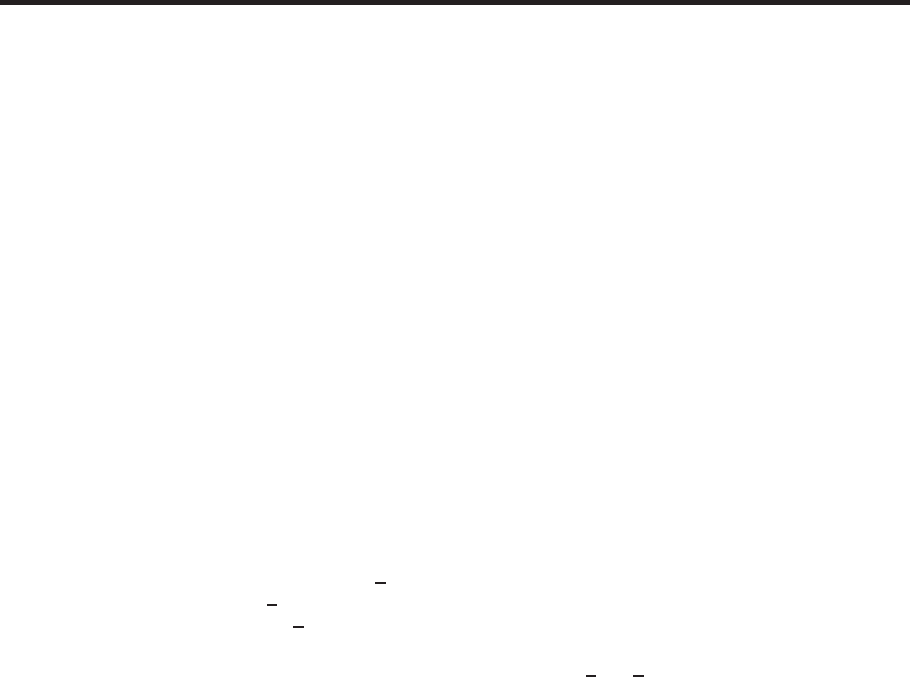
SOLUTIONS to Review Problems for Chapter Eighteen 1705
Then ~r ′(t) = (2 sin t)
~
i+ (2 cos t)~
j, so
ZC2
~
F·d~r =ZC2
(5y~
i+ 4x~
j)·d~r
=Zπ
0
(5(4 + 2 sin t)
~
i+ 4(5 −2 cos t)~
j)·(2 sin t
~
i+ 2 cos t~
j)dt
=Zπ
0
(40 cos t−16 cos2t+ 40 sin t+ 20 sin2t)dt
= 88.283.
The integral has been computed numerically. The exact answer, obtained using the Table of Integrals, is 80 + 2π.
Problems
31. If a vector field is a gradient vector field, it has zero circulation around every closed curve. Vector fields (i) and (iii) do
not have this property. Therefore, (ii) and (iv) could represent gradient vector fields.
32. (a) The curves C1and C3give line integrals which we expect to be zero because at every point, the curve looks perpen-
dicular to the vector field.
(b) The curve C4gives a negative line integral because the path is traversed in the direction opposite to the vector field.
(c) The line integrals along C2,C5,C6and C7are all positive. The vector field is path-independent; it is the gradient
of a function fwhose contours appear to be equally spaced circles centered at the origin; the value of fincreases
going outward. By the Fundamental Theorem of Line Integrals, the value of a line integral is the difference between
the values of fat the two endpoints. The difference between the radii of the circles containing the endpoints of C2
and the difference between the radii of the circles containing the endpoints of C6look about the same, so the line
integrals along C2and C6are approximately equal. Since C6and C7have the same endpoints, their line integrals are
also equal. The difference between the radii of the circles containing the endpoints of C2is less than the difference
between the radii of the circles containing the endpoints of C5, so the line integral along C2is smaller than the line
integral along C5. Thus
C2=C6=C7< C5.
33. The original integral is around the unit circle, oriented counterclockwise.
(a) This integral uses the same parameterization, but goes twice around the circle. The value of the integral is 24.
(b) This integral uses the same parameterization, but with the limits reversed and with −d~r instead of d~r . Thus, the
value of the integral does not change; it is 12.
(c) This integral uses a different parameterization of the circle x= sin t, y = cos t, which goes once around the circle
clockwise. The value of the integral is −12.
34. (a) The path Cis a line segment, tangent to ~
T=~
i+~
jat every point. Because the path Cis on the line y=xwe have
~
F(x, y) = 2
~
i+ 2~
j= 2~
Ton C. Thus ~
Fis tangent to Cat every point and points in the direction of the orientation
of C. The angle between Cand ~
Fis 0.
(b) On Cwe have k~
Fk=k2
~
i+ 2~
jk= 2√2.
(c) The path Chas length 5√2. Since the vector field ~
Fis everywhere tangent to Cin the direction of the orientation
and of constant magnitude 2√2we have
ZC
~
F·d~r =k~
Fk · Length of C= 2√2·5√2 = 20.
35. (a) For path (i), we have x(t) = t, y(t) = t2, so x′(t) = 1, y′(t) = 2t. Thus,
ZC
~
F·d~r =Z1
0
~
F(t, t2)·(
~
i+ 2t~
j)dt
=Z1
0
[(t+t2)
~
i+t~
j]·(
~
i+ 2t~
j)dt
=Z1
0
(t+3t2)dt

1706 Chapter Eighteen /SOLUTIONS
= ( t2
2+t3)
1
0
=1
2+ 1 −(0 + 0) = 3
2.
For path (ii), we have x(t) = t2, y(t) = t, so x′(t) = 2t, y′(t) = 1.Thus,
ZC
~
F·d~r =Z1
0
~
F(t2, t)·(2t
~
i+~
j)dt
=Z1
0
[(t2+t)
~
i+t2~
j]·(2t
~
i+~
j)dt
=Z1
0
(2t3+ 3t2)dt
= ( t4
2+t3)
1
0
=1
2+ 1 −(0 + 0) = 3
2.
For path (iii), we have x(t) = t, y(t) = tn, so x′(t) = 1, y′(t) = ntn−1.Thus,
ZC
~
F·d~r =Z1
0
~
F(t, tn)·(
~
i+ntn−1~
j)dt
=Z1
0
[(t+tn)
~
i+t~
j]·(
~
i+ntn−1~
j)dt
=Z1
0
(t+tn+ntn)dt
=Z1
0
(t+(n+ 1)tn)dt
=t2
2+tn+1
1
0
=1
2+ 1 −(0 + 0) = 3
2.
(b) If f(x, y) = xy +x2/2, we have ~
F= grad f. Each path goes from (0,0) to (1,1). Thus in each case
ZC
~
F·d~r =f(1,1) −f(0,0) = 3
2.
36. The path Cis the displacement ~v = (4 −5)
~
i+ (7 −5)~
j=−~
i+ 2~
j . Since the vector field is constant, the line integral
is ZC
(2
~
i+ 13~
j)·d~r = (2
~
i+ 13~
j)·(−~
i+ 2~
j) = −2 + 26 = 24
37. This is a gradient vector field,
4x
~
i+ 3y~
j= grad 2x2+3
2y2.
Thus,
ZC
(4x
~
i+ 3y~
j)·d~r = (2x2+3
2y2)
(4,7)
(5,5)
= 2 ·42+3
2·72−2·52−3
2·52= 18.
38. This is not a gradient field, so we parameterize the line segment. The vector from (5,5) to (4,7) is ~v =−~
i+ 2~
j, so the
parameterization is
x= 5 −t, y = 5 + 2t, 0≤t≤1,

SOLUTIONS to Review Problems for Chapter Eighteen 1707
and d~r = (−~
i+ 2~
j)dt. The integral is
ZC
((4x+ 5y)
~
i+ (2x+ 3y)~
j)·d~r
=Z1
0
(4(5 −t) + 5(5 + 2t))
~
i+ (2(5 −t) + 3(5 + 2t)~
j)·(−~
i+ 2~
j)dt
=Z1
0−(20 −4t+ 25 + 10t) + 2(10 −2t+ 15 + 6t)dt
=Z1
0
(5 + 2t)dt = 5t+t21
0= 6.
39. Since the curve is closed, we use Green’s Theorem:
ZC
((4x+ 5y)
~
i+ (2x+ 3y)~
j)·d~r =ZR∂
∂x (2x+ 3y)−∂
∂y (4x+ 5y)dA =ZR−3dA =−3·Area of star.
Each of the four points of the star has area 1
2·2·2 = 2; the square center has area 22= 4, so area of star is 4·2 + 4 = 12.
Thus, ZC
((4x+ 5y)
~
i+ (2x+ 3y)~
j)·d~r =−3·12 = −36.
40. (a) By Green’s Theorem, if Ris the interior of C,
ZC
~
F·d~r =ZR∂
∂x (5x)−∂
∂y (2y)dA =ZR
3dA = 3 ·Area of region = 3 2·1
210(9 −1)= 240.
(b) On C1, we have y= 1, so ~
F= 2
~
i+ 5x~
j. Only the~
icomponent contributes to the line integral, so
ZC1
~
F·d~r = 2 ·Length of C1= 2 ·20 = 40.
(c) Since C=C1+C2, we have
ZC2
~
F·d~r =ZC
~
F·d~r −ZC1
~
F·d~r = 240 −40 = 200.
41. (a) Since ~
F= grad(x2ey)is a gradient vector field and Cis a closed curve, RC~
F·d~r = 0.
(b) Since
∂G2
∂x −∂G1
∂y =∂
∂x (x+y)−∂
∂y (x−y) = 2,
by Green’s Theorem,
ZC
~
G·d~r =ZR∂G2
∂x −∂G1
∂y dA = 2 ·Area of triangle =2·3·8
2= 24.
42. (a) Since ~
F= grad x3/3+x3y4, the Fundamental Theorem of Line Integrals gives
ZC1
~
F·d~r =x3
3+x3y4
(−2,0)
(2,0)
=−8
3+ 0 −8
3+ 0=−16
3.
(b) Since a gradient field is path-independent, and the endpoints of C1and C2are the same:
ZC2
~
F·d~r =ZC1
~
F·d~r =−16
3.
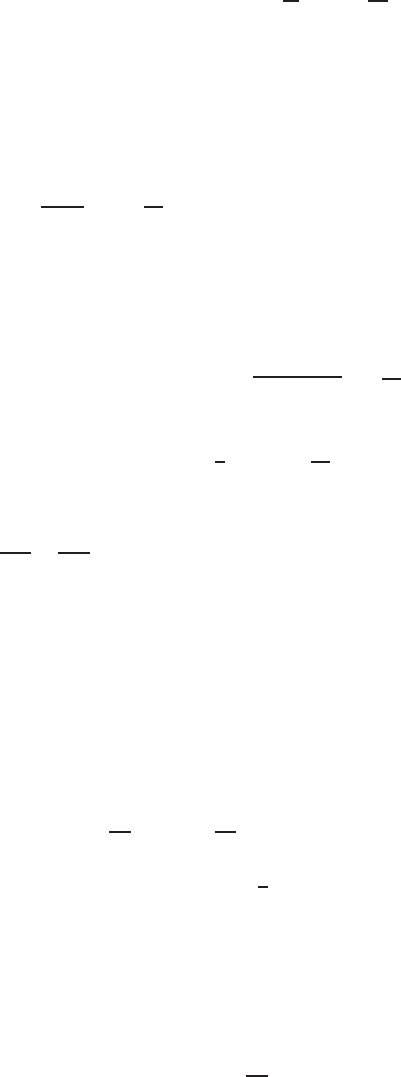
1708 Chapter Eighteen /SOLUTIONS
(c) The vector field ~
Gis not a gradient vector field, so we parameterize C1. Using x(t) = t,y(t) = 0, from t= 2 to
t=−2gives ZC1
~
G·d~r =Z−2
2
(t4+ 0)
~
i+ (0~
j)·~
i dt =Z−2
2
t4dt =t5
5
−2
2
=−64
5.
(d) Parameterizing C2by x(t) = 2 cos t, y(t) = 2 sin tfor 0≤t≤πgives
ZC2
~
G·d~r =Zπ
0(2 cos t)4+ (2 cos t)3(2 sin t)2~
i+ (2 cos t)2(2 sin t)3~
j·(−2 sin t
~
i+ 2 cos t~
j)dt
= 32 Zπ
0
(−cos4tsin t−2 cos3tsin3t+ 2 cos3tsin3t)dt
=−32 Zπ
0
cos4tsin t dt = 32 cos5t
5
π
0
=−64
5.
43. (a) The vector field is everywhere perpendicular to the radial line from the origin to (2,3), so the line integral is 0.
(b) Since the path is parallel to the x-axis, only the~
icomponent of the vector field contributes to the line integral. The~
i
component is −3
~
ion this line, and the displacement along this line is −2
~
i, so
Line integral = (−3
~
i)·(−2
~
i) = 6.
(c) The circle of radius 5 has equation x2+y2= 25. On this curve, ||~
F|| =p(−y2) + x2=√25 = 5. In addition,
~
Fis everywhere tangent to the circle, and the path is 3/4of the circle. Thus
Line integral =||~
F|| · Length of curve = 5 ·3
4·2π(5) = 75
2π.
(d) Use Green’s Theorem. Writing Cfor the curve around the boundary of the triangle, we have
∂F2
∂x −∂F1
∂y = 1 −(−1) = 2,
so ZC
~
F·d~r =ZTriangle
2dA = 2 ·Area of triangle = 2 ·7 = 14.
44. (a) Since ~
F= (6x+y2)
~
i+ 2xy~
j= grad(3x2+xy2), the vector field ~
Fis path independent, so
ZC1
~
F·d~r = 0.
(b) Since C1is closed, we use Green’s Theorem, so
ZC1
~
G·d~r =ZInterior of C1∂
∂x (x+y)−∂
∂y (x−y)dA
= 2 ZC1
dA = 2 ·Area inside C1= 2 ·1
2·2·2 = 4.
(c) Since ~
F= grad(3x2+xy2), using the Fundamental Theorem of Line Integrals gives
ZC2
~
F·d~r = (3x2+xy2)
(0,−2)
(2,0)
= 0 −3·22=−12.
(d) Parameterizing the circle by
x= 2 cos t y = 2 sin t0≤t≤3π
2,
gives
x′=−2 sin t y′= 2 cos t,
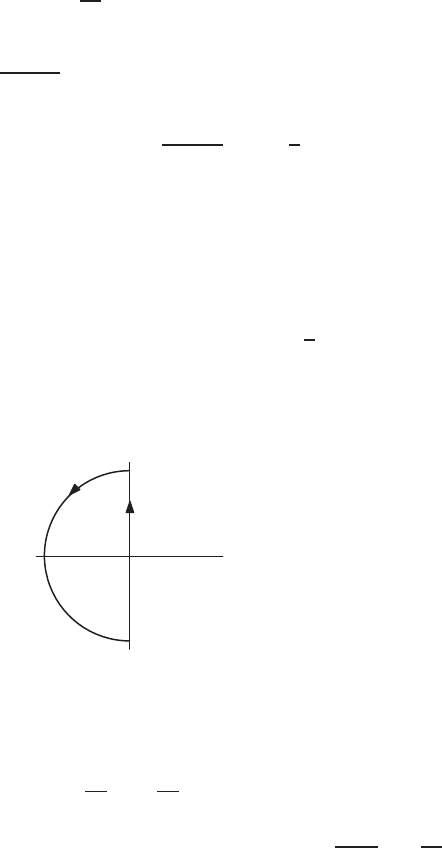
SOLUTIONS to Review Problems for Chapter Eighteen 1709
so the integral is
ZC2
~
G·d~r =Z3π/2
0(2 cos t−2 sin t)
~
i+ (2 cos t+ 2 sin t)~
j·(−2 sin t
~
i+ 2 cos t~
j)dt
=Z3π/2
0
4(−cos tsin t+ sin2t+ cos2t+ sin tcos t)dt
= 4 Z3π/2
0
dt = 4 ·3π
2= 6π.
45. (a) Since ~
F=x
~
i+y~
j= grad x2+y2
2, we know that ~
Fis a gradient vector field. Thus, by the Fundamental
Theorem of Line Integrals,
ZOA
~
F·d~r =x2+y2
2
(3,0)
(0,0)
=9
2.
(b) We know that ~
Fis path independent. If Cis the closed curve consisting of the line in part (a) followed by the
two-part curve in part (b), then ZC
~
F·d~r = 0.
Thus, if ABO is the two-part curve of part (b) and OA is the line in part (a),
ZABO
~
F·d~r =−ZOA
~
F·d~r =−9
2.
46. (a) C1is a line along the vertical axis; C2is a half circle from the positive yto the negative y-axis. See Figure 18.36.
−1
1
C1
C2
x
y
Figure 18.36
(b) Either use Green’s Theorem or calculate directly. Using Green’s Theorem, with Ras the region inside C, we get
ZC1+C2
~
F·d~r =ZR∂
∂x (y)−∂
∂y (x+ 3y)dA
=ZR−3dA=−3(Area of region) = −3π·12
2=−3π
2.
47. See Figure 18.37. The example chosen is the vector field ~
F(x, y) = y~
jand the path Cis the line from (0,−1) to (0,1).
Since the vectors are symmetric about the x-axis, the dot products ~
F·∆~r cancel out along Cto give 0for the line
integral. Many other answers are possible.
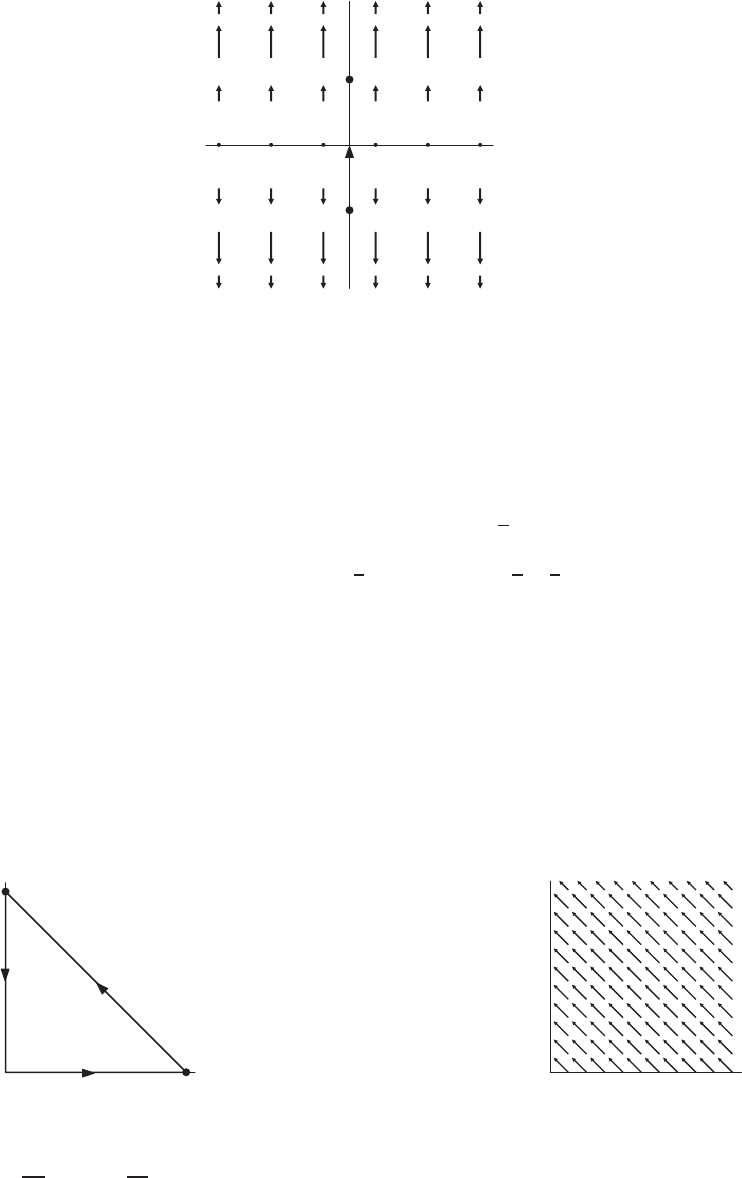
1710 Chapter Eighteen /SOLUTIONS
(0,−1)
(0,1)
x
y
C
Figure 18.37
48. (a) See Figure 18.38. Notice that C=C1+C2+C3is a closed curve.
(b) See Figure 18.39.
(c) (i) Since the component of ~
Fin the direction of C1is −~
i,
ZC1
~
F·d~r =−Length of C1=−1.
(ii) Since ~
Fis parallel to C2and in the same direction, and ||~
F|| =√2,
ZC2
~
F·d~r =√2·Length of C2=√2·√2 = 2.
(iii) Since the component of ~
Fin the direction of C3is ~
j, and a vector in the direction of C3is −~
j,
ZC3
~
F·d~r =−Length of C3=−1.
(iv) Since ~
Fis constant, it is a gradient field and Cis closed,
ZC
~
F·d~r = 0.
C1
C2
C3
(1,0)
(0,1)
x
y
Figure 18.38
x
y
Figure 18.39
49. (a) Since ∂
∂x (y5+x)−∂
∂y (x3−y) = 1+1 = 2, any closed curve oriented counterclockwise will do. See Figure 18.40.
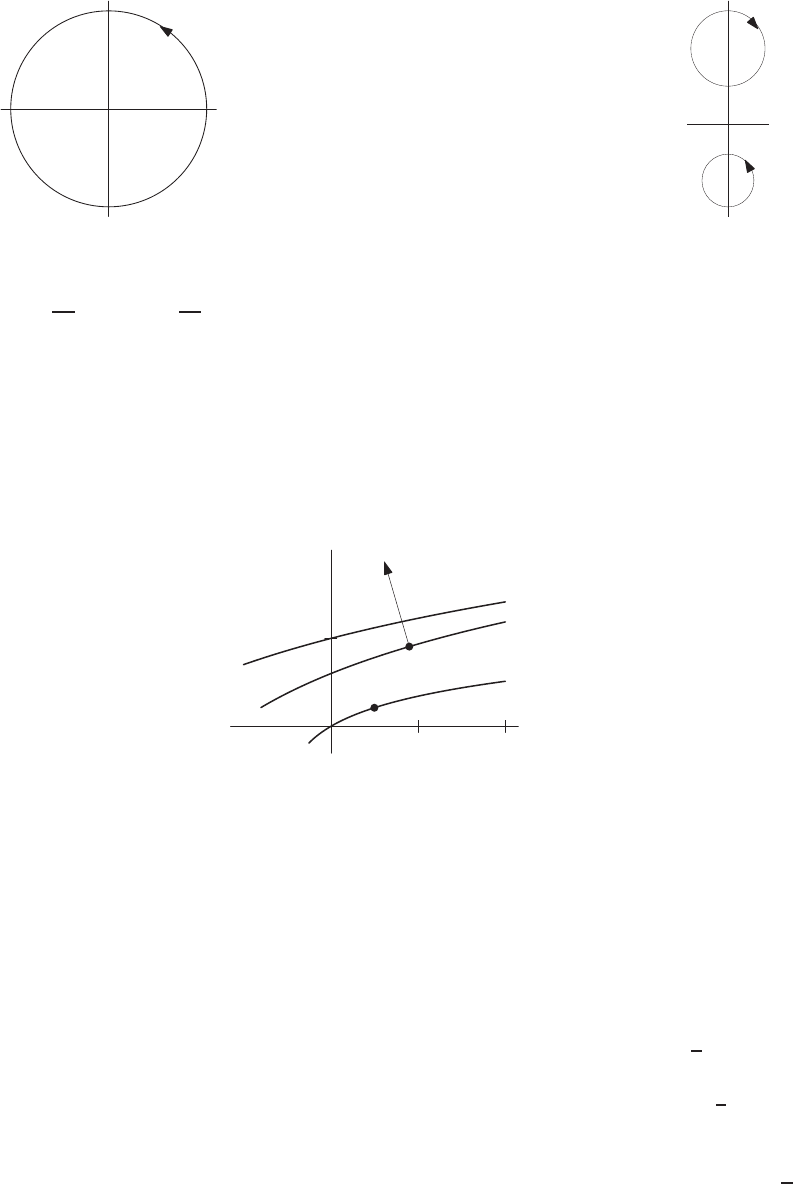
SOLUTIONS to Review Problems for Chapter Eighteen 1711
x
y
Figure 18.40
x
y
Figure 18.41
(b) Since ∂
∂x (y5−xy)−∂
∂y (x3) = −y, any closed curve in the lower half-plane oriented counterclockwise or any
closed curve in the upper half-plane oriented clockwise will do. See Figure 18.41. Other answers are possible.
50. A contour of fis a set on which fdoes not change, so the total change of ffrom Pto Q,f(P)−f(Q), is zero. If Cis
a part of a contour of f, we know that grad fis perpendicular to C. This means that the line integral of grad falong C,
which also computes the total change in fbetween its endpoints, must be zero, since the dot products in its definition are
all zero.
51. (a) The vector field ∇fis perpendicular to the level curves, in direction of increasing f. The length of ∇fis the rate of
change of fin that direction. See Figure 18.42
1 2
1
22.7
23
23.3
Q
P
x
y
Figure 18.42
(b) Longer.
(c) Using the Fundamental Theorem of Calculus for Line Integrals, we have
ZC∇f·d~r =f(Q)−f(P) = 22.7−23 = −0.3.
52. (a) (i) The curve Cis the line given by ~r =x
~
i+y~
j, which we can parameterize by x=t,y=−t+1 for 0≤t≤1.
Then ~r ′(t) = ~
i−~
jso
ZC
~
v·d~r =Z1
0
((1 −t)
~
i+ 2t~
j)·(
~
i−~
j)dt =Z1
0
(1 −3t)dt =−1
2.
(ii) The curve Cis the circle given by ~r =x
~
i+y~
jwhere x= sin t,y= cos tfor 0≤t≤π
2. Thus ~r ′(t) =
cos t
~
i−sin t~
jand
ZC
~
v·d~r =Zπ/2
0
(cos t
~
i+ 2 sin t~
j)·(cos t
~
i−sin t~
j)dt =Zπ/2
0
(cos2t−2 sin2t)dt =−π
4.
(b) Since the value of the integral along two paths gives different results, ~v is not path independent.
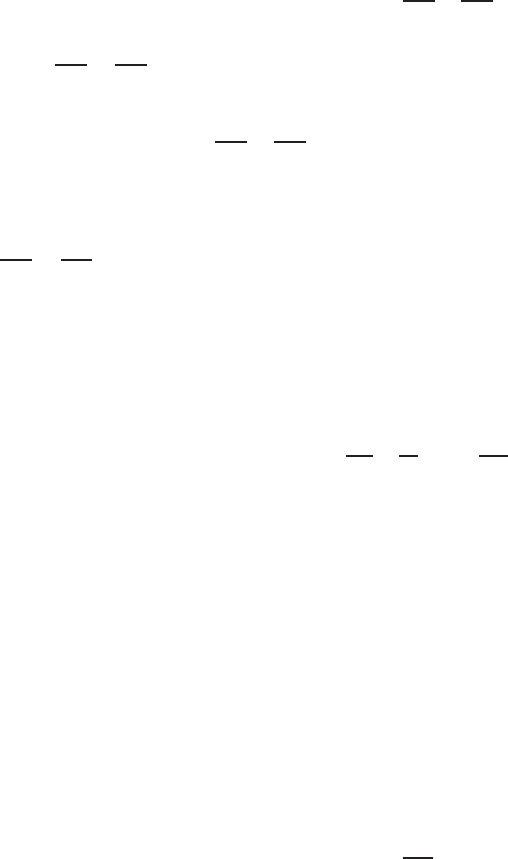
1712 Chapter Eighteen /SOLUTIONS
53. (a) The path Cis a line segment, tangent to ~
T=~
i+~
jat every point. Because the path Cis on the line y=xwe have
~
F(x, y) = 2
~
i−2~
jon C. Hence ~
T·~
F= 0, which shows that Cand ~
Fare perpendicular at every point of C. The
angle between them in π/2.
(b) RC~
F·d~r = 0 because ~
Fand Care perpendicular at every point of C.
54. By Green’s Theorem, if Rais the interior of Ca
ZCa
~
F·d~r =ZRa∂F2
∂x −∂F1
∂y dA.
The quantity ∂F2
∂x −∂F1
∂y is positive for points (x, y)near the origin and negative farther away. This quantity changes
sign where
∂F2
∂x −∂F1
∂y = 3(x2+y2)−(x2+y2)3/2= 0
3(x2+y2) = (x2+y2)3/2
(x2+y2)1/2= 3.
Thus ∂F2
∂x −∂F1
∂y is positive within C3, the circle of radius 3, and negative outside. The maximum value of the line
integral occurs when a= 3. Converting to polars,
ZC3
~
F·d~r =ZR33(x2+y2)−(x2+y2)3/2dA
=Z2π
0Z3
0
(3r2−r3)r dr dθ
= 2π3r4
4−r5
5
3
0
=35π
10 .
55. We’ll assume that the rod is positioned along the z-axis, and look at the magnetic field ~
Bin the xy-plane. If Cis a circle
of radius rin the plane, centered at the origin, then we are told that the magnetic field is tangent to the circle and has
constant magnitude k~
Bk. We divide the curve Cinto little pieces Ciand then we sum ~
B·∆~r computed on each piece
Ci. But ∆~r points nearly in the same direction as ~
B, that is, tangent to C, and has magnitude nearly equal to the length
of Ci. So the dot product is nearly equal to k~
Bk× length of Ci. When all of these dot products are summed and the limit
is taken as k∆~r k → 0, we get
ZC
~
B·d~r =k~
Bk × length of C=k~
Bk × 2πr
Now Amp`ere’s Law also tells us that ZC
~
B·d~r =kI
Setting these expressions for the line integral equal to each other and solving for k~
Bkgives kI = 2πrk~
Bk, so
k~
Bk=kI
2πr .
56. (a) An example of a central field is in Figure 18.43.
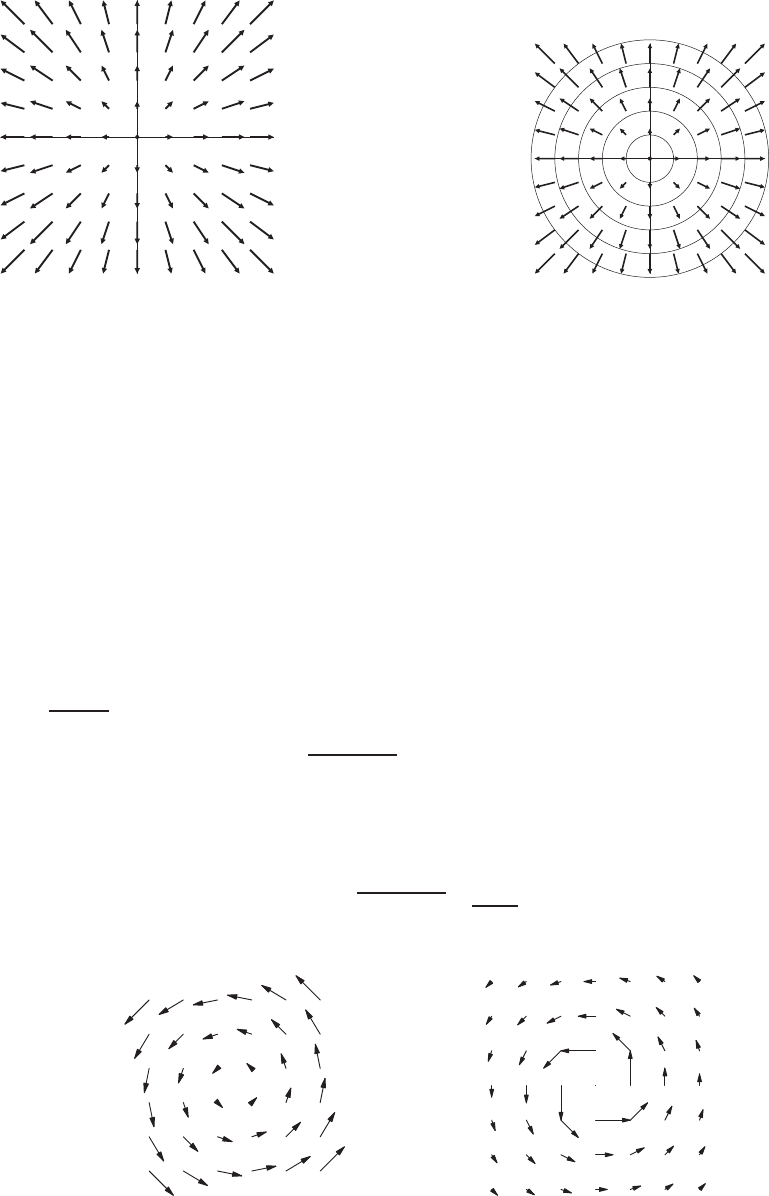
SOLUTIONS to Review Problems for Chapter Eighteen 1713
x
y
Figure 18.43
x
y
Figure 18.44
(b) The vectors of ~
Fare radial and the contours of fmust be perpendicular to the vectors. Therefore, every contour
must be a circle centered at the origin. Sketching some contours results in a diagram like that in Figure 18.44.
(c) No, not every gradient field is a central field, because there are gradient fields which are not perpendicular to circles.
An example is the gradient of f(x, y) = y, where grad f=~
j, so the gradient is parallel to the yaxis. Thus, ~
F=~
j
is an example of a gradient field which is not a central field.
(d) When a particle moves around a circle centered at O, no work is done, because ~
Fis tangent to the circle. Thus the
only work done in moving from Pto Qis in moving between the circles. Since ~
Fis central, the work done on any
radial line between C1and C3, for example, depends on only the radii of C1and C3(~
Fis parallel to this path and
its magnitude is a function of the distance to the center of the circle only). For that reason, on a path which goes from
C1to C2and then from C2to C3, the same amount of work will be done as on a path direct from C1to C3.
(e) Pick any two points Pand Q. Any path between them can be well-approximated by a path which is partly radial and
partly around a circle centered at O. By the answer to part d), the work along any such path depends only on the radii
of the circles on which Pand Qsit, not on the path. Thus, the work done is independent of the path. Hence, ~
Fmust
be path-independent and therefore a gradient field.
57. (a) Since −y~
i+x~
jis a counterclockwise rotation, both ωand Kmust be positive. In order to find the values of ωand
K, we must look at the velocity field where we know the magnitude. At a radius of 100 m from the center, we know
that px2+y2= 100,and that k~v k= 3 ·105. Thus, using ~v =ω(−y~
i+x~
j)we get
k~v k=ωp(−y)2+x2= 100ω= 3 ·105meters/hr,
so
ω= 3000 rad/hr.
Using ~v =K(x2+y2)−1(−y~
i+x~
j)gives
k~v k=|K|(x2+y2)−1p(−y)2+x2=K100
1002= 3 ·105meters/hr,
so K= 3 ·107meters2·rad/hr.
(b)
Figure 18.45 Figure 18.46
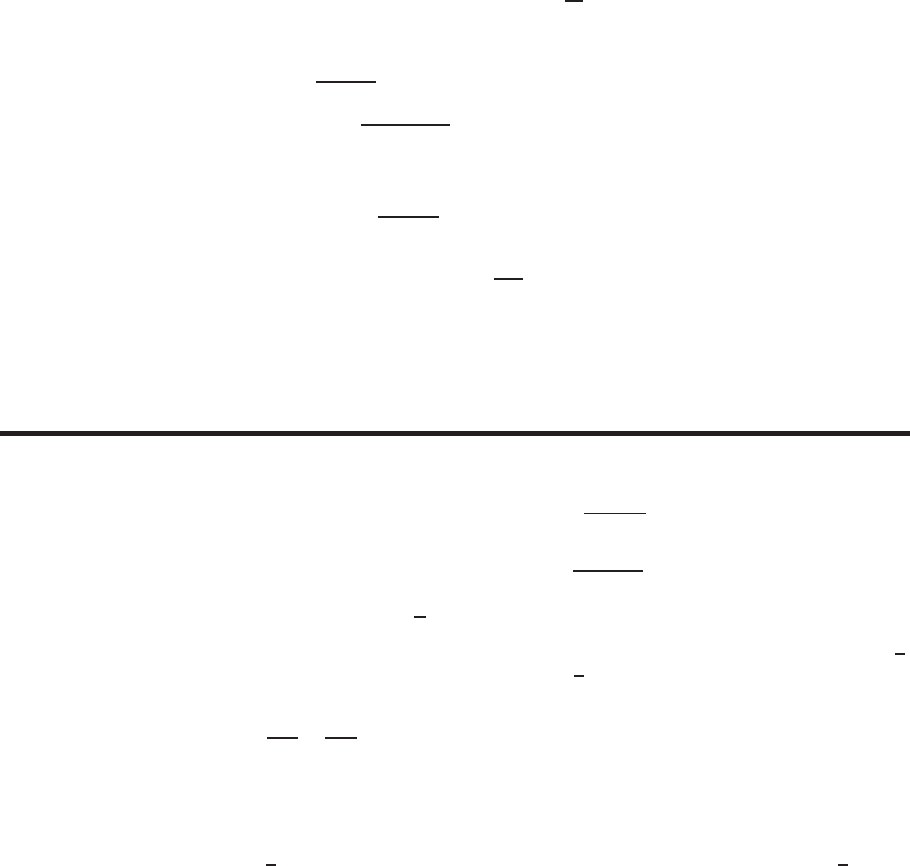
1714 Chapter Eighteen /SOLUTIONS
The vector field in Figure 18.45 shows the velocity vectors inside the tornado, (i.e. r < 100 meters). The vector
field in Figure 18.46 shows the velocity vectors as seen from a great distance (i.e. r >> 100 meters) with the tornado
at the origin.
(c) Let Cbe the circle of radius raround the origin. If r < 100 meters, the velocity vectors at distance rfrom the origin
have magnitude ωr. Since they are tangent, and point counterclockwise, the circulation is
ZC
~
v·d~r =k~v k · Length of C= 2ωπr2.
If r≥100 meters, the vectors at distance rfrom the origin have magnitude K/r and are again tangent to the circle.
The circulation here is ZC
~
v·d~r =kvk · Length of C= ( K
r)2πr = 2Kπ.
58. The free vortex appears to starts at about r= 200 meters (that’s where the graph changes its behavior) and the tangential
velocity at this point is about 200 km/hr = 2 ·105meters/hr.
Since ~v =ω(−y~
i+x~
j)for px2+y2≤200, at r= 200 we have
k~v k=ωp(−y)2+x2=ω(200) = 2 ·105meters/hr,
so
ω= 103rad/hr.
Since ~v =K(x2+y2)−1(−y~
i+x~
j)for px2+y2≥200, at r= 200 we have
k~v k=K(2002)−1(200) = K
200 = 2 ·105meters/hr
so
K= 4 ·107m2·rad/hr.
CAS Challenge Problems
59. (a) We parameterize Caby ~r (t) = acos t
~
i+asin t~
j. Then, using a CAS, we find
ZCa
~
F(~
r(t)) ·~r ′(t)dt =Z2π
0
acos t2acos t−a3cos t3
3+a3cos tsin t2
−asin t−(asin t) + 2a3sin t3
3dt
=−π
2(−6a2+a4)
The derivative of the expression on the right with respect to ais −(2π)(−3a+a3), which is zero at a= 0,±√3.
Checking at a= 0 and as a→ ∞, we find the maximum is at a=√3.
(b) We have
∂F2
∂x −∂F1
∂y = (2 −x2+y2)−(−1 + 2y2) = 3 −x2−y2.
So, by Green’s theorem, ZCa
~
F·d~r =Z ZDa
(3 −x2−y2)dA,
where Dais the disk of radius acentered at the origin. The integrand is positive for x2+y2<3, so it is positive
inside the disk of radius √3and negative outside it. Thus the integral has its maximum value when a=√3.
60. We parameterize the line from (0,0) to (x, y)by ~r (t) = t(x
~
i+y~
j). Using a CAS to compute the integral, we get
(a)
f(x, y) = Z1
0
~
F(~
r(t)) ·~r ′(t)dt =Z1
0
2axyt dt =axy +Constant
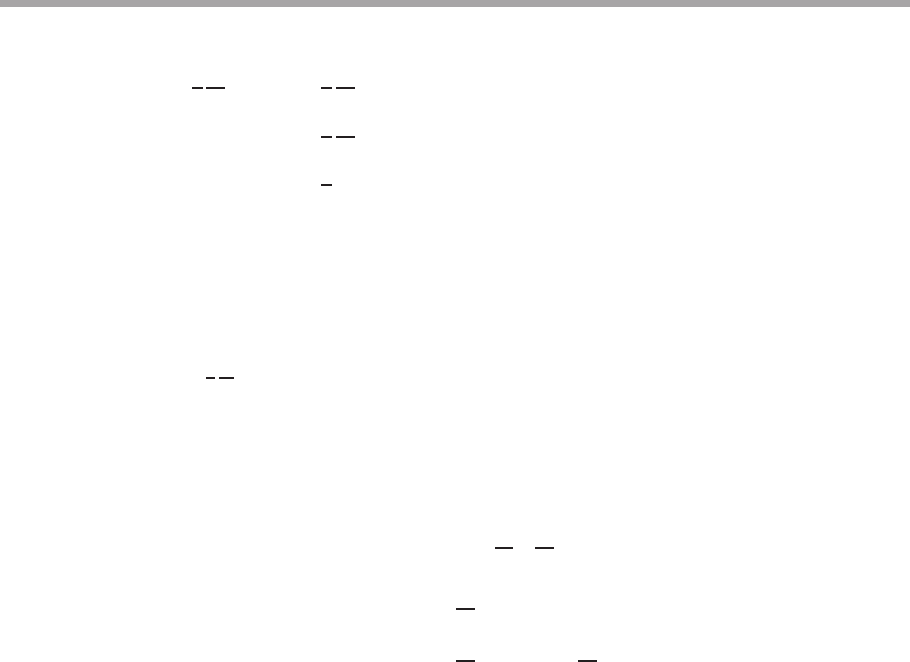
PROJECTS FOR CHAPTER EIGHTEEN 1715
(b)
f(x, y) = Z1
0
~
F(~r (t)) ·~r ′(t)dt
=Z1
0
(abebt2xy txy + (c+abebt2xy tx)y)dt =aebxy +cy +Constant
61. We have
ZC1
~
F·d~r =Z3
0
~
F(~r (t)) ·~r ′(t)dt
=Z3
0
(22at +bt2+ 2t2ct +dt2)dt = 18a+ 18b+ 36c+ (81d/2)
and
ZC2
~
F·d~r =Z3
0
~
F(~
r(t)) ·~r ′(t)dt
=Z3
0−22a(3−t) + b(3 −t)2−22c(3 −t) + d(3 −t)2(3 −t)dt
=−18a−18b−36c−(81d/2)
The second integral is the negative of the first. This is because C2is the same curve as C1but traveling in the opposite
direction.
PROJECTS FOR CHAPTER EIGHTEEN
1. (a) Since k~v (t)k2=~v (t)·~v (t)and since ~v (t) = ~r ′(t) = x′(t)
~
i+y′(t)~
j+z′(t)~
k, we have
1
2
d
dtk~v (t)k2=1
2
d
dt(~v (t)·~v (t))
=1
2
d
dt(x′(t)2+y′(t)2+z′(t)2)
=1
2(2x′(t)x′′(t) + 2y′(t)y′′(t) + 2z′(t)z′′(t))
=x′(t)x′′(t) + y′(t)y′′(t) + z′(t)z′′(t)
= (x′(t)
~
i+y′(t)~
j+z′(t)~
k)·(x′′(t)
~
i+y′′(t)~
j+z′′(t)~
k)
=~v (t)·~a (t)(Since ~a (t) = x′′(t)
~
i+y′′(t)~
j+z′′(t)~
k.)
=~
a(t)·~v (t).
(b) (i) We use ~
F=m~a and the parameterization of Cgiven by r(t)for t0≤t≤t1.In addition, we need
the fact that 1
2
d
dt k~v (t)k2=~a ·~v :
ZC
~
F·d~r =ZC
m~a ·d~r =Zt1
t0
m~a ·~r ′dt
=Zt1
t0
m(~a ·~v )dt
=Zt1
t0
m
2d
dtk~v (t)k2dt
=m
2k~v (t)k2
t1
t0
=m
2k~v (t1)k2−m
2k~v (t0)k2
=Kinetic energy at Q−Kinetic energy at P.
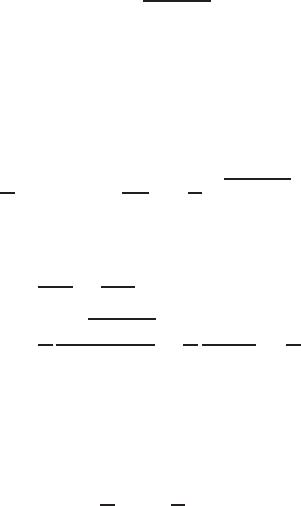
1716 Chapter Eighteen /SOLUTIONS
(ii) Since ~
F=−∇fwe use the Fundamental Theorem of Line Integrals:
ZC
~
F·d~r =ZC−∇f·d~r =−(f(~r (t1)) −f(~r (t0)))
=−(Potential energy at Q−Potential energy at P)
=Potential energy at P−Potential energy at Q.
(iii) In parts (a) and (b) we derived two expressions for the work done by ~
Fas the particle moves from P
to Q. These two expressions must be equal, so
Kinetic energy at Q−Kinetic energy at P=Potential energy at P−Potential energy at Q.
Rewriting this equation we have,
(Potential energy +Kinetic energy)at P= (Potential energy +Kinetic energy)at Q.
This shows that the total energy is the same at Pas at Q. Since Pand Qare arbitrary points in space,
the total energy of a particle moving in a force vector field ~
F=−∇fis a constant.
2. (a) We have
~m = (x−a)
~
i+y~
j .
Since ~m has magnitude Lwe have
(x−a)2+y2=L2
and so
x−a=pL2−y2
where we have used the fact that a< x. Thus
~
k×~m =−y~
i+ (x−a)~
j .
Using once more the fact that ~m has magnitude L, we see that the unit vector ~
Fin the direction of ~
k×~m
is
~
F=1
L(~
k×~m ) = −y
L~
i+1
LpL2−y2~
j .
(b) We have
curl ~
F=∂F2
∂x −∂F1
∂y
=1
L
∂pL2−y2
∂x −1
L
∂(−y)
∂y =1
L.
(c) By Green’s Theorem and part (b), we have
ZC
~
F·d~r =ZR
curl ~
FdA
=ZR
1
LdA =1
L·(Area of R).
Since ~
Fis by definition in part (a) a vector field of unit vectors in the direction of the wheel vector along
C, we have
(Area of R) = LZC
~
F·d~r =L·(Total roll of planimeter wheel).
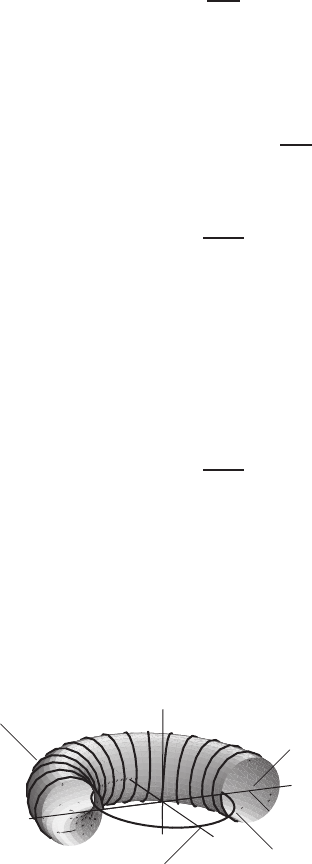
PROJECTS FOR CHAPTER EIGHTEEN 1717
3. (a) We take the surface to be a disk of radius r, parallel to the xy-plane and centered on the z-axis. The
boundary of the disk is the circle C. We know that the magnetic field, ~
B, is tangent to the circle and has
constant magnitude, k~
Bk, along each circle. Thus, for any such circle,
ZC
~
B·d~r =k~
Bk · Length of C= 2πrk~
Bk.
If r≥r0(where r0is the radius of the wire) then the current through the surface is I. Therefore
2πrk~
Bk=ZC
~
B·d~r =kI,
so
k~
Bk=kI
2πr .
If r < r0, then the current flowing through the surface is not I, but the amount of current passing through
a disk of radius r. Such a disk has an area which is (πr2)/(πr2
0)of the cross-sectional area of the wire. So
the current to use in Amp`ere’s Law is (πr2)/(πr2
0)I. Thus,
2πrk~
Bk=ZC
~
B·d~r =kπr2
πr2
0
I.
Solving for k~
Bkgives
k~
Bk=kIr
2πr2
0
.
(b) We again use Amp`ere’s Law on a disk of radius r, lying perpendicular to, and centered on, the z-axis (See
Figure 18.47). If the boundary, C, of this disk lies inside the torus, then the wire goes through the disk N
times, and so the net current through the disk is N I. Thus,
2πrk~
Bk=ZC
~
B·d~r =kN I,
which gives
k~
Bk=kNI
2πr .
On the other hand, if the boundary, C, lies outside the torus, then the net current through the disk is 0. (The
wire goes into the disk Ntimes and out of the disk Ntimes, and so the currents cancel.) Hence we have
2πrk~
Bk=ZC
~
B·d~r = 0.
So k~
Bk= 0.
x
y
z
✠
(0, β, 0)
✒
(β,0,0)
❘
α
■
Circle
C
of radius r;
boundary of horizontal
disk
❘
Wires forming
solenoid
Figure 18.47
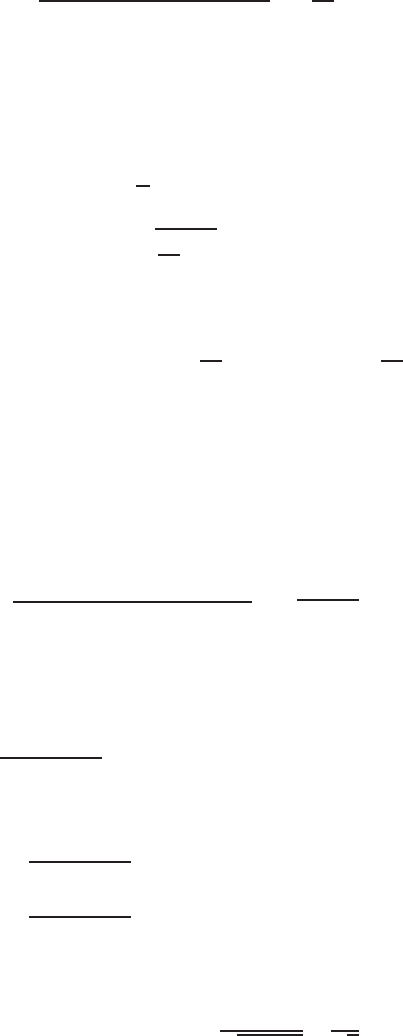
1718 Chapter Eighteen /SOLUTIONS
4. (a) (i) For each plane ~
F=−c||~v ||~v and since ~r ′(t) = ~v (t), the work done is given by
ZC
~
F·d~r =Zπ
0
(−c||~v (t)||~v (t)) ·~v (t)dt =−cZπ
0||~v (t)||3dt.
The velocity of the first airplane is
~v 1(t)= (−2 sin t)~ı + (2 cos t)~ + 3~
k .
Since
||~v 1(t)|| =p(−2 cos t)2+ (2 sin t)2+ 32=√13,
the work done by the force ~
F1is
W1=ZC
~
F1·d~r 1=−cZπ
0||~v 1(t)||3dt =−cZπ
0
133/2dt =−133/2πc.
For the second plane
~v 2(t)=−4
π~
i+ 3~
k ,
so
||~v 2(t)|| =r16
π2+ 9,
and the work done by the force ~
F2is
W2=ZC
~
F2·d~r 2=−cZπ
0||~v 2(t)||3dt =−cZπ
016
π2+ 93/2
dt =−16
π2+ 93/2
πc.
(ii) At time t= 0, both airplanes are at the point (2,0,0). At t=π, both airplanes are at the point
(−2,0,3π); therefore, their trajectories have the same endpoints. The fact that W16=W2shows that
the drag force is not conservative, since the work done by a conservative force is the same on all paths
with the same endpoints.
(b) (i) The first plane’s path is given by
~r 1(t)= 2 cos t
~
i+ 2 sin t~
j+ 3t~
k ,
so
||~r 1(t)|| =p(2 cos t)2+ (2 sin t)2+ (3t)2=p4+9t2,
and
~v 1(t)=~r ′
1(t) = (−2 sin t)
~
i+ (2 cos t)~
j+ 3~
k .
Thus, the gravitational force acting on the first airplane at time tis
~
F1(t) = −GMm
(4 + 9t2)3/2((2 cos t)~ı + (2 sin t)~ + 3t~
k),
so the total work done by the gravitational force on the first plane is
W1=Zπ
0
~
F1(t)·~
v1(t)dt =Zπ
0−GMm
(4 + 9t2)3/2(2 cos t
~
i+ 2 sin t~
j+ 3~
k)·(−2 sin t
~
i+ 2 cos t~
j+ 3t~
k)dt
=Zπ
0−GMm
(4 + 9t2)3/2·9t dt.
Using the substitution x= 4 + 9t2, we get
W1=GMm(4 + 9t2)−1/2
π
0
=GMm 1
√4+9π2−1
√2.
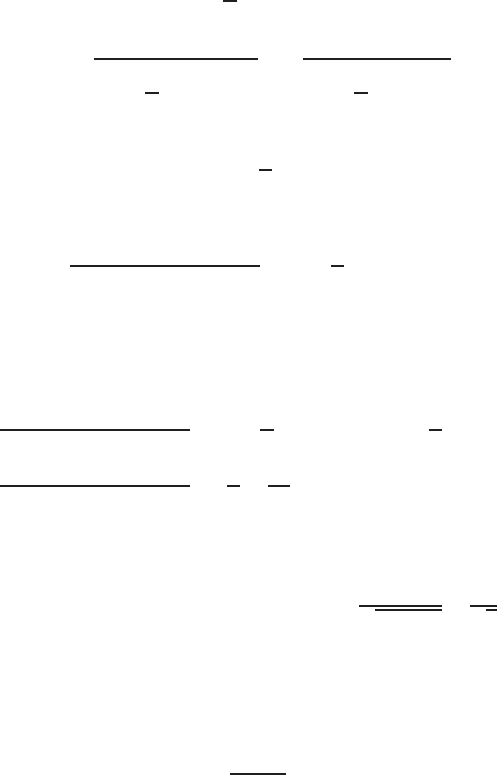
PROJECTS FOR CHAPTER EIGHTEEN 1719
Similarly, for the second plane, we have
~r 2(t) = 2−4
πt~
i+ 3t~
k ,
so
||~r 2(t)|| =s2−4
πt2
+ (3t)2=s2−4
πt2
+ 9t2,
and
~v 2(t)=~r ′
2(t) = −4
π~
i+ 3~
k .
Thus, the gravitational force on the second plane is
~
F2(t) = −GMm
((2 −4t/π)2+ 9t2)3/22−4
πt~
i+ 3t~
k,
so the work done by the gravitational force on the second plane is
W2=Zπ
0
~
F2(t)·~v 2(t)dt
=Zπ
0−GMm
((2 −4t/π)2+ 9t2)3/22−4
πt~
i+ 3t~
k·−4
π~
i+ 3~
kdt
=Zπ
0−GMm
((2 −4t/π)2+ 9t2)3/2−8
π+16
π2t+ 9tdt.
Using the substitution x= (2 −4t/π)2+ 9t2, we get
W2=GMm((2 −(4t/π))2+ 9t2)−1/2
π
0
=GMm 1
√4+9π2−1
√2.
(ii) The fact that W1=W2suggests that ~
Fmight be conservative, since a conservative force does the
same work along two paths with the same endpoints. That this is indeed the case can be seen from the
fact that ~
Fis a gradient vector field with potential function
ϕ(~r ) = −GM m
||~r || ,
(so that ~
F=−grad ϕ).

19.1 SOLUTIONS 1721
CHAPTER NINETEEN
Solutions for Section 19.1
Exercises
1. The surface is a right triangle in the yz-plane with sides 2 and 3, so its area is (1/2) ·2·3 = 3. The area vector ~
Ais
perpendicular to the plane yz-plane, so ~
Ais a multiple of~
iwith magnitude 3. There are two such vectors, 3
~
iand −3
~
i.
Since ~
Apoints in the negative xdirection, we have ~
A=−3
~
i.
2. The disc has area πR2= 25π. The area vector ~
Ahas magnitude 25πand is perpendicular to the xy-plane. Since it points
upward, the area vector is ~
A= 25π~
k.
3. The surface is a 5×3rectangle of area 15. The area vector ~
Ais perpendicular to the plane y= 10, so ~
Ais a multiple of
~
jwith magnitude 15. There are two such vectors, 15~
jand −15~
j. Since y > 0and ~
Apoints away from the xz-plane,
we have ~
A= 15~
j.
4. The surface is a 5×3rectangle of area 15. The area vector ~
Ais perpendicular to the plane y=−10, so ~
Ais a multiple
of ~
jwith magnitude 15. There are two such vectors, 15~
jand −15~
j. Since y < 0and ~
Apoints away from the xz-plane,
we have ~
A=−15~
j.
5. We need a flat surface with area 150 that is perpendicular to the vector ~
j. There are many examples. For instance, we can
take any 3×50 rectangle in the xz-plane oriented in the positive ydirection.
6. Scalar. Only the ~
j-component of the vector field contributes to the flux and d~
A=~
j dA, and on the disk y= 6, so
ZS
(x
~
i+6~
j)·d~
A= 6 ·Area of disk = 6 ·π32= 54π.
7. (a) Only the ~
k-component of the vector field contributes to the flux and d~
A=~
k dA, so
ZS
(4
~
i+ 5~
k)·d~
A= 5 ·Area of square = 5 ·32= 45.
(b) This flux is the negative of the flux in part (a) because the surface is oriented in the opposite direction, so its value is
−45.
Calculating directly, here d~
A=−~
k dA, so
ZS
(4
~
i+ 5~
k)·d~
A=−5·Area of square =−5·32=−45.
8. (a) Only the~
i-component of the vector field contributes to the flux and d~
A=−~
i dA, so
ZS
(2
~
i+ 3~
j)·d~
A=−2·Area of disk =−2·π42=−32π.
(b) This flux is the negative of the flux in part (a) because the surface is oriented in the opposite direction, so its value is
32π.
Calculating directly, here d~
A=~
i dA, so
ZS
(2
~
i+ 3~
j)·d~
A= 2 ·Area of disk = 2 ·π42= 32π.
9. (a) The flux is positive, since ~
Fpoints in direction of positive x-axis, the same direction as the normal vector.
(b) The flux is negative, since below the xy-plane ~
Fpoints toward negative x-axis, which is opposite the orientation of
the surface.
(c) The flux is zero. Since ~
Fhas only an x-component, there is no flow across the surface.
(d) The flux is zero. Since ~
Fhas only an x-component, there is no flow across the surface.
(e) The flux is zero. Since ~
Fhas only an x-component, there is no flow across the surface.

1722 Chapter Nineteen /SOLUTIONS
10. The vector field ~
F=F1
~
i+F2~
j+F3~
k=−z~
i+x~
kis a field parallel to the xz-plane that suggests swirling around
the origin from the positive x-axis to the positive z-axis.
(a) The flux going through this surface is negative, because ~
F·~n = (−z~
i+x~
k)·~
i=−z,zis positive here.
(b) The flux going through this surface is positive, because ~
F·~n =−z,zis negative here.
(c) The flux through this surface is negative, because ~
F·~n = (−z~
i+x~
k)·(−~
k) = −x,xis positive.
(d) The flux through this surface is negative, because ~
F·~n =−x,xis positive.
(e) The flux through this surface is zero, because it is in the xz-plane, which is parallel to the vector field.
11. The vector field ~r is a field that always points away from the origin.
(a) The flux through this surface is zero, because the plane is parallel to the field.
(b) The flux through this surface is zero also, for the same reason.
(c) The flux through this surface is zero also, for the same reason.
(d) The flux through this surface is negative, because the field in that quadrant is going up and away from the origin, and
since the orientation is downward, the flux is negative.
(e) The flux through this surface is zero also.
12. The area of the rectangular region is 4, and the orientation vector is ~
k. So, ~
A= 4~
k, and the flux is ~v ·~
A= (
~
i+ 2~
j−
3~
k)·4~
k=−12.
13. The rectangular region is parallel to the yz-plane and has area 8. The orientation vector is ~
i, so ~
A= 8
~
iand the flux is
~v ·~
A= (
~
i+ 2~
j−3~
k)·8
~
i= 8.
14. The rectangle lies in the plane z+ 2y= 4. So a normal vector is 2~
j+~
kand a unit normal vector is 1
√5(2~
j+~
k). Since
this points in the positive z-direction it is indeed an orientation for the rectangle. Since the area of this rectangle is 4√5
we have ~
A= 8~
j+ 4~
k,
~v ·~
A= (
~
i+ 2~
j−3~
k)·(8~
j+ 4~
k) = 16 −12 = 4.
15. The rectangle lies in the plane 3x+ 2z= 6. So 3
~
i+ 2~
kis a normal vector and 1
√13 (3
~
i+ 2~
k)is a unit normal vector.
Since this points in both the positive x-direction and the positive z-direction, it is an orientation for this surface. Since the
area of the rectangle is 2√13, we have ~
A= 6
~
i+ 4~
kand ~v ·~
A= (
~
i+ 2~
j−3~
k)·(6
~
i+ 4~
k) = 6 −12 = −6.
16. On the surface, d~
A=~
k dA, so only the ~
kcomponent of ~v contributes to the flux:
Flux =ZS
~
v·d~
A=ZS
(
~
i−~
j+ 3~
k)·~
k dA = 3 ·Area of disk = 3 ·π22= 12π.
17. On the surface, d~
A=~
i dA, so only the~
icomponent of ~v contributes to the flux:
Flux =ZS
~
v·d~
A=ZS
(
~
i−~
j+ 3~
k)·~
i dA =Area of triangle = 4.
18. On the surface, d~
A=~
i dA, so only the~
icomponent of ~v contributes to the flux:
Flux =ZS
~
v·d~
A=ZS
(
~
i−~
j+ 3~
k)·~
i dA =Area of square = 4.
19. The triangle lies in the plane x+y+z= 1, with normal~
i+~
j+~
k. A unit normal is ~n = (
~
i+~
j+~
k)/√3, so
Flux =ZS
~v ·d~
A=ZS
(
~
i−~
j+ 3~
k)·~
i+~
j+~
k
√3dA =3
√3Area of triangle .
The base of the triangle in the xy-plane has length √2; the height is p3/2, so the area is √3/2. Thus
Flux =3
√3·√3
2=3
2.
20. Since the surface is closed and the vector field is constant, the flux is zero.
21. Since the surface is in the plane x= 2, only the ~
i-component contributes to the flux. The area vector of the surface is
π12
~
i=π~
i. Thus, ZS
(2
~
i+ 3~
j+ 5~
k)·d~
A= 2
~
i·π~
i= 2π.
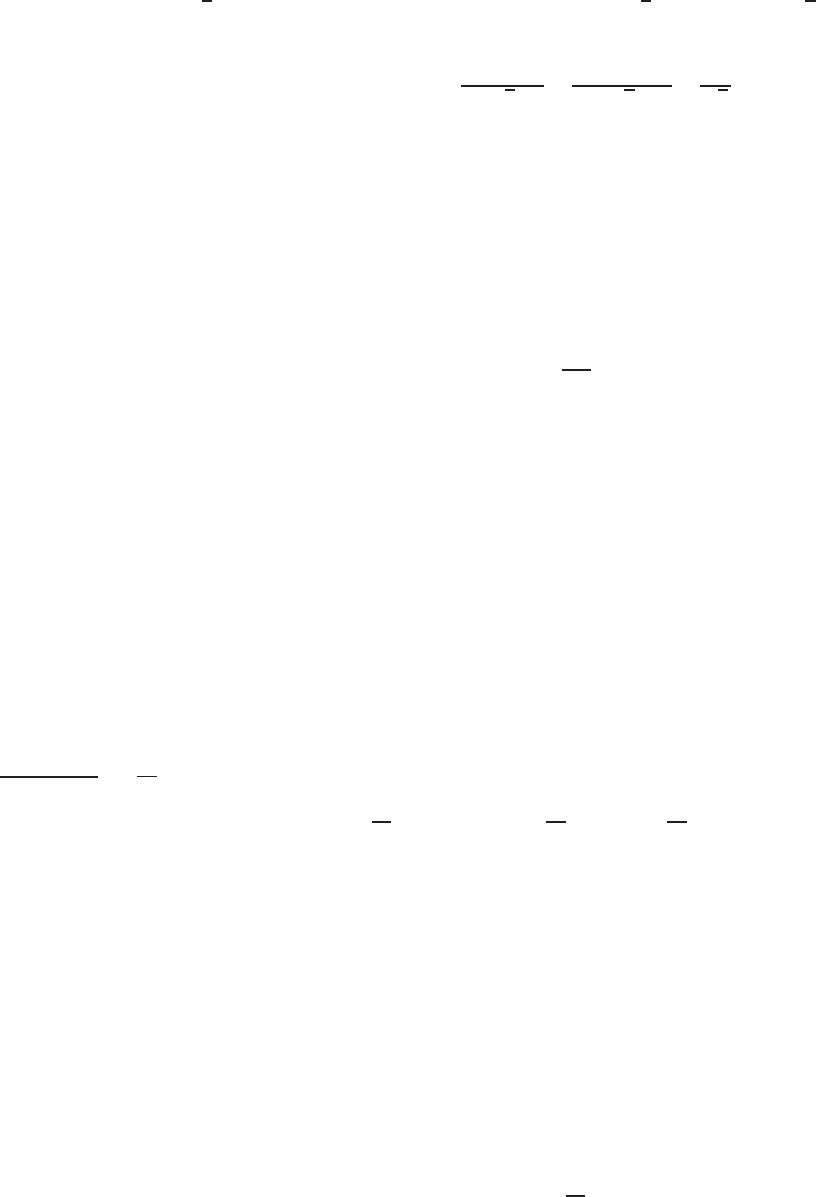
19.1 SOLUTIONS 1723
22. Since the surface is in the plane x+y+x= 1, whose normal vector is~
i+~
j+~
k, a unit normal in the direction of the
orientation is (
~
i+~
j+~
k)/√3.Thus, the area vector of the surface is π12(
~
i+~
j+~
k)/√3 = π(
~
i+~
j+~
k)/√3.The
flux is given by
ZS
(2
~
i+ 3~
j+ 5~
k)·d~
A= (2
~
i+ 3~
j+ 5~
k)·π~
i+~
j+~
k
√3=π(2 + 3 + 5)
√3=10π
√3.
23. Since the surface is closed, the flux of a constant vector field out of it is 0.
24. The only contribution to the flux is from the face x= 1, since the vector field is zero or parallel to the other faces. On this
face, ~
G=~
i. This face has area 6, so its area vector ~
A= 6
~
i. Thus
Flux =~
i·~
A= 6.
25. The only contribution to the flux is from the face z= 3, since the vector field is zero or parallel to the other faces. On this
face, ~
H= 3x~
k. The vector field is everywhere perpendicular to the face z= 3 but varies in magnitude from point to
point. On this surface, d~
A=~
k dx dy. Thus
Flux =Z2
0Z1
0
3x~
k·~
kdx dy =Z2
0Z1
0
3x dx dy =3x2
2
1
0·y
2
0
= 3.
26. Only the x-component of the vector field contributes to the flux. On the surface, ~
F= 3
~
i+ 4~
jand d~
A=−~
i dA, so
ZS
(3
~
i+ 4~
j)·d~
A=−3·Area of disk =−3·π52=−75π.
27. Since ~r is perpendicular to Sand ||~r || = 3 on S, we have
ZS
~
r·d~
A= 3 ·Area of surface = 3 ·4π32= 108π.
28. Only the~
icomponent contributes to the flux. On S, we have d~
A=~
i dA and x= 3π/2, so
ZS
(sin x
~
i+ (y2+z2)~
j+y2~
k)·d~
A= sin(3π/2) ·Area of disk =−1·π(π2) = −π3.
29. Since 5
~
i+ 5~
j+ 5~
kis perpendicular to Sand in the same direction as the orientation, and since ||5
~
i+ 5~
j+ 5~
k|| =
√52+ 52+ 52=√75 on S, we have
ZS
(5
~
i+ 5~
j+ 5~
k)·d~
A=√75 ·Area of circle =√75 ·π32= 9π√75.
30. Since the vector field ~
Flies in the plane of the square, the flux is 0.
31. Since the disk is in the yz-plane, d~
A=~
i dA and only the~
icomponent of ~
Fcontributes to the flux:
Flux =~
F·~
A= 2 ·Area of disk = 2π.
32. The square is in the plane y= 5, so only the ~
jcomponent of ~
Fcontributes to the flux. This component is 5~
jon the
square and the area vector ~
Ais parallel to ~
j, so
Flux =~
F·~
A= 5 ·Area of square = 5(1.6)2= 12.8.
33. The plane is z=−2. Since the vector field is −2~
kon the plane, it is parallel to the normal and in the same direction, and
of length 2 there. Thus,
Flux =ZS
z~
k·d~
A=2·Area of square = 2 ·(√14)2= 28.
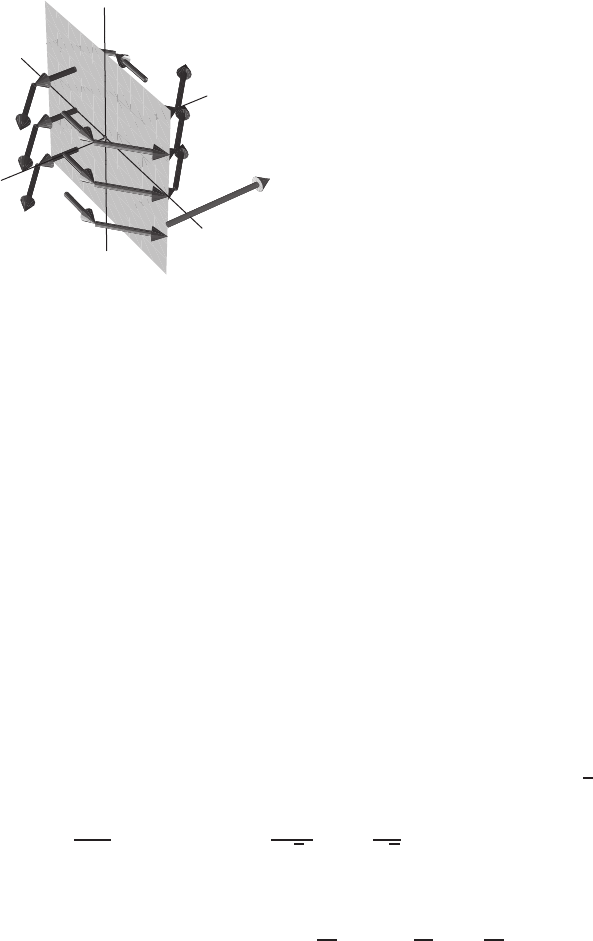
1724 Chapter Nineteen /SOLUTIONS
34. See Figure 19.1. The vector field is a vortex going around the z-axis, and the square is centered on the x-axis, so the flux
going across one half of the square is balanced by the flux coming back across the other half. Thus, the net flux is zero, so
ZS
~
F·~
dA= 0.
x
y
z
~n
Figure 19.1
35. Only the~
i-component contributes to the flux, so
ZS
~
F·d~
A=7·Area of disk = 7 ·π22= 28π.
36. In the plane y= 3, we have ~
F=x
~
i+ 6~
j+ 3z~
k. Only the ~
j-component contributes to the flux, so
ZS
~
F·d~
A= 6 ·Area of square = 6 ·22= 24.
37. Since the vector field is constant, the flux is zero.
38. On the sphere of radius 2, the vector field has ||~
F|| = 10 and points inward everywhere (opposite to the orientation of
the surface). So
Flux =ZS
~
F·d~
A=−||~
F|| · Area of sphere =−10 ·4π22=−160 π.
39. We have d~
A=~
k dA, and z= 4, so,
ZS
~
F·d~
A=ZS
(x
~
i+y~
j+(42+ 3)~
k)·~
k dA =ZS
19 dA
= 19(Area of rectangle) = 19(6) = 114.
40. The normal to the plane is ~n =~
i+~
j; a unit vector in this direction and in the direction of orientation is (
~
i+~
j)/√2.
Thus,
Flux = (6
~
i+ 7~
j)·~n
||~n || ·Area of triangle =6 + 7
√2·10 = 130
√2.
41. The only contribution to the flux is from the ~
j-component, and since d~
A=~
j dx dz on the square, S, we have
Flux =ZS
(6
~
i+x2~
j−~
k)·d~
A=Z2
−2Z2
−2
x2~
j·~
j dx dz =Z2
−2
x3
3
2
−2
dz =16
3·4 = 64
3.
42. We have d~
A=~
i dA, and x= 4, so,
ZS
~
F·d~
A=ZS
((4 + 3)
~
i+ (y+ 5)~
j+ (z+ 7)~
k)·~
i dA =ZS
7dA
= 7 ·Area of rectangle = 7 ·6 = 42.
43. On the sphere of radius 3, the vector field has ||~
F|| = 21 and points outward everywhere. So
Flux =ZS
~
F·d~
A=||~
F|| · Area of sphere = 21 ·4π32= 756 π.
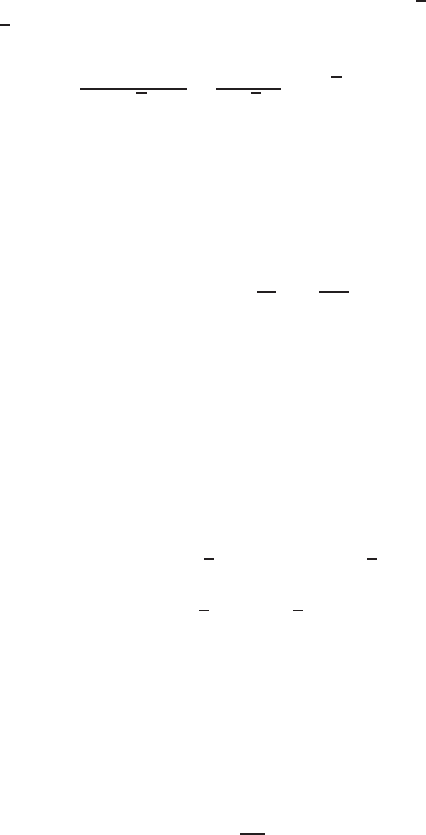
19.1 SOLUTIONS 1725
44. The vector field ~
Fand the area vector on the surface of the sphere are parallel, but in opposite directions. Since ~
Fis
pointing inward and ||~
F|| = 6 on the surface
Flux =ZS
~
F·d~
A=ZS||~
F||cos π dA =−6·Area of sphere =−6·4π22=−96π.
45. We have d~
A=~
i dA, so
ZS
~
F·d~
A=ZS
(2z~
i+x~
j+x~
k)·~
i dA =ZS
2z dA
=Z2
0Z3
0
2z dzdy = 18.
46. Since the vector field is constant, if ~
Ais the area vector of the square
Flux =~
F·~
A .
An upward normal to the plane is~
i+~
j+~
k, so a unit vector in this direction is (
~
i+~
j+~
k)√3. The area vector has
magnitude 4, so ~
A= 4(
~
i+~
j+~
k)/√3. Thus
Flux = (
~
i+ 2~
j)·4(
~
i+~
j+~
k)
√3=4(1 + 2)
√3= 4√3.
47. Since the disk is in the xy-plane and oriented upward, d~
A=~
k dxdy and
ZDisk
~
F·d~
A=ZDisk
(x2+y2)~
k·~
kdxdy =ZDisk
(x2+y2)dxdy.
Using polar coordinates ZDisk
~
F·d~
A=Z2π
0Z3
0
r2·r drdθ = 2πr4
4
3
0
=81π
2.
48. Since the disk is horizontal and oriented upward, d~
A=~
k dxdy, so
ZDisk
~
F·d~
A=ZDisk
cos(x2+y2)~
k·~
k dxdy =ZDisk
cos(x2+y2)dxdy.
Using polar coordinates, since the disk has radius 3, we have
ZDisk
~
F·d~
A=ZDisk
cos(x2+y2)dxdy =Z2π
0Z3
0
cos(r2)rdrd θ
=Z2π
0
1
2sin(r2)
3
0
dθ = 2π·1
2sin(r2)
3
0
= 2π1
2sin(32)−1
2sin(02)=πsin 9.
49. Since the disk is oriented in the positive x-direction, d~
A=~
i dydz, so we have
Flux =ZDisk
~
F·d~
A=ZDisk
ey2+z2~
i·~
idydz =ZDisk
ey2+z2dydz.
To calculate this integral, we use polar coordinates with y=rcos θand z=rsin θ. Then r2=y2+z2and
ZDisk
~
F·d~
A=Z2π
0Z2
0
er2·rdrdθ = 2π·er2
2
2
0
=π(e4−1).

1726 Chapter Nineteen /SOLUTIONS
50. See Figure 19.2. Since ~
Fis parallel to the xy plane, there is no flux across the surface, so
ZS
~
F·~
dA= 0.
x
y
z~n
Figure 19.2
51. See Figure 19.3. The area vector of a small area element ∆~
Ais the vector pointing in the direction normal to the surface
with magnitude ∆A. The unit vector normal to the surface is ~
k, so ∆~
A=~
k∆A. Thus,
ZS
~
F·~
dA = lim
k∆~
Ak→0X~r ·∆~
A= lim
k∆Ak→0X~r ·~
k∆~
A=ZS
~r ·~
k dA.
Now ~r ·~
k= 2 for all the points on Sbecause all such points have z-coordinate equal to 2. Thus, we have
ZS
~
F·d~
A=ZS
~
r·~
k dA =ZS
2dA = 2 ·Area of S= 8π.
x
y
z
~n
~r
Figure 19.3
52. See Figure 19.4. Since the vector field is parallel to the x-axis, only the two sides perpendicular to the x-axis contribute to
the flux integral. On the side where x= 0, the vector field is 2
~
i, and hence the flux through that side is −(2)(32) = −18
(negative because the flow is inward and the normal vector is pointing out). The flow out the other side is at x= 3, so
~
F=−~
i, so the flux out that side is (−~
i)·(32
~
i) = −9. So the net flux is −18 −9 = −27. So
ZS
~
F·~
dA=−27.
x
y
z
Figure 19.4
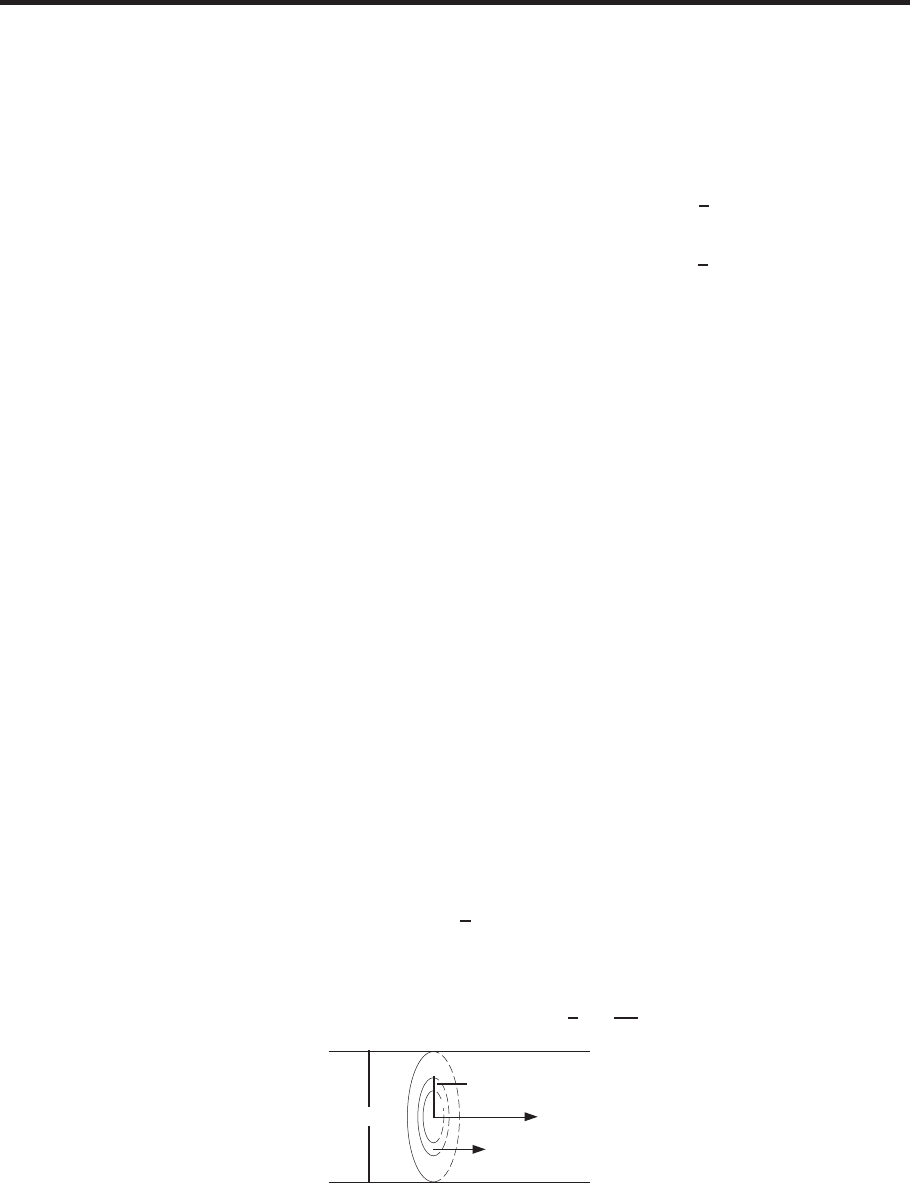
19.1 SOLUTIONS 1727
Problems
53. (a) (i) The flux RBx
~
i·d~
Ais positive. The vectors x
~
iall point out of the box.
(ii) The flux RBy~
i·d~
Ais zero. The vector field is parallel to the x-axis. For each y-value, the flux entering the box
at one end cancels the flux leaving at the other end.
(iii) The flux RS|x|~
i·d~
Ais zero. The flux entering the sphere where x < 0cancels the flux leaving where x > 0.
(iv) Since RS(y−x)
~
i·d~
A=Ry~
i·d~
A−Rx
~
i·d~
A=Zero −Positive , this flux is negative.
(b) From the Divergence Theorem, RBx
~
i·d~
Ais greater. Since div(x
~
i) = 1,
ZS
x
~
i·d~
A=ZInside sphere
1·dV=Volume of sphere =4
3π.
ZB
x
~
i·d~
A=ZInside box
1·dV =Volume of box = 8 >4
3π.
54. (a) Consider two opposite faces of the cube, S1and S2. The corresponding area vectors are ~
A1= 4~ı and ~
A2=−4~ı
(since the side of the cube has length 2). Since ~
Eis constant, we find the flux by taking the dot product, giving
Flux through S1=~
E·~
A1= (a
~
i+b~
j+c~
k)·4
~
i= 4a.
Flux through S2=~
E·~
A2= (a
~
i+b~
j+c~
k)·(−4
~
i) = −4a.
Thus the fluxes through S1and S2cancel. Arguing similarly, we conclude that, for any pair of opposite faces, the
sum of the fluxes of ~
Ethrough these faces is zero. Hence, by addition, RS~
E·d~
A=0.
(b) The basic idea is the same as in part (a), except that we now need to use Riemann sums. First divide Sinto two
hemispheres H1and H2by the equator Clocated in a plane perpendicular to ~
E. For a tiny patch S1in the hemisphere
H1, consider the patch S2in the opposite hemisphere which is symmetric to S1with respect to the center O of the
sphere. The area vectors ∆~
A1and ∆~
A2satisfy ∆~
A2=−∆~
A1, so if we consider S1and S2to be approximately
flat, then ~
E·∆~
A1=−~
E·∆~
A2.By decomposing H1and H2into small patches as above and using Riemann
sums, we get ZH1
~
E·d~
A=−ZH2
~
E·d~
A,so ZS
~
E·d~
A= 0.
(c) The reasoning in part (b) can be used to prove that the flux of ~
Ethrough any surface with a center of symmetry is
zero. For instance, in the case of the cylinder, cut it in half with a plane z= 1 and denote the two halves by H1and
H2. Just as before, take patches in H1and H2with ∆A1=−∆A2, so that ~
E·∆A1=−~
E·∆~
A2. Thus, we get
ZH1
~
E·d~
A=−ZH2
~
E·d~
A,
which shows that ZS
~
E·d~
A= 0.
55. Notice that the speed is 3cm/sec at the center of the pipe and 0cm/sec at the sides. Suppose~
iis the unit vector parallel
to the direction of flow. Then, at a distance rfrom the center of the pipe, the velocity is given by
~v =3−3
4r2~
icm/sec.
Divide the circular cross-section into concentric rings of width ∆r, so that the velocity is approximately constant on
each one. The area of a typical ring is ∆A≈2πr∆r. Then since ~v and ∆~
Aare parallel (see Figure 19.5), we have
Flux through ring ≈~v ∆~
A=k~v kk∆~
Ak ≈ 3−3
4r2cm
sec ·(2πr∆r)cm2.
✻
❄
4
cm
✻
❄
✻
❄
r
✛∆r
∆~
A
~v
Figure 19.5
: Flux through pipe when
velocity varies with distance from the center
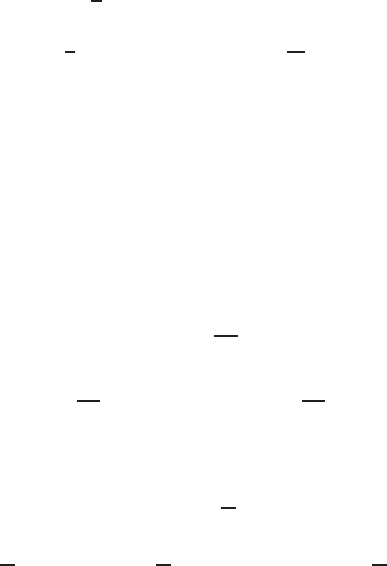
1728 Chapter Nineteen /SOLUTIONS
Thus, the flux through the circular cross-section of the pipe is given by
Flux = lim
k∆~
Ak→0X~v ·∆~
A
= lim
∆r→0X3−3
4r22πr∆r
=Zr=2
r=0 3−3
4r22πr dr = 6πZ2
0r−r3
4dr = 6πcm3/sec.
56. (a) The net electric flux through this surface is zero, because the surface is placed so that it is always parallel with the
electric field, and there is no flow through the surface.
(b) The net flux is zero, because the flow in through one half of the cylinder is canceled by the flow out through the other
half.
57. The ~
jcomponents of ~
Gand ~
Hdo not have flux through Sbecause they are parallel to the cylinder that Slies on, and
are therefore tangent to S. The three vector fields, ~
F,~
G, and ~
Hhave the same ~
iand ~
kcomponents, so they have the
same flux through S.
58. Since this vector field points radially out from the origin, it is everywhere parallel to the vector representing the surface
area, d~
A. Thus since k~
F(~r )k= 1/R2on the surface, S,
~
F(~r )·d~
A=1
R2dA,
so ZS
~
F(~
r)·d~
A=1
R2·Surface area of sphere =1
R2(4πR2) = 4π.
59. Since this vector field points radially out from the origin, it is everywhere parallel to the area vector, ∆~
A. Thus since
k~
F(~r )k= 1/R on the surface, S,
~
F(~r )·∆~
A=1
R∆A
so ZS
~
F(~r )·d~
A=1
Rlim
∆A→0X∆A=1
R·Surface area of sphere =1
R(4πR2) = 4πR.
60. (a) The vector field is perpendicular to the surface of a sphere centered at the origin. Thus the magnitude of the flux
depends on the magnitude of the vector field on the surface. Since for fixed ~r , the value of ||~
F|| decreases as p
increases, the maximum flux occurs when p= 0.
(b) For a sphere of radius 2 with p= 0, we have ||~
F|| = 2 on the surface. Thus
Flux =ZS
~
F·d~
A=2·Area of surface = 2 ·4π22= 32π.
61. (a) For a flat surface, flux through ~
Ais ~v ·~
A. Therefore, the flux through each face of the cube is equal to (−~
i+ 2~
j+
~
k)·(~
Aof the face).
First we shall find the flux through the two faces parallel to the xy-plane, beginning with the one with negative
z. The unit vector normal to this face and pointing outward is −~
k. The area of the face equals 4, so ~
A=−4~
k. The
flux through the face with negative zequals
(−~
i+ 2~
j+~
k)·(−4~
k) = 0 + 0 −4 = −4
For the face with positive z, the unit normal vector that points outward is ~
k. Therefore ~
A= 4~
k. The flux through
this face is given by
(−~
i+ 2~
j+~
k)·4~
k= 0 + 0 + 4 = 4
Next, we will find the flux through the two faces parallel to the xz-plane, beginning with the one with negative
y. A unit vector normal to this face pointing outward is −~
j. Therefore ~
A=−4~
j. The flux then equals
(−~
i+ 2~
j+~
k)·(−4~
j) = 0 −8 + 0 = −8
For the face with positive y, the unit normal vector pointing outward is ~
j. Therefore ~
A= 4~
j . The flux then equals
(−~
i+ 2~
j+~
k)·(4~
j) = 0 + 8 + 0 = 8
19.1 SOLUTIONS 1729
Next, we will find the flux through the two faces parallel to the yz plane, beginning with the one with negative
x. A unit vector normal to this plane pointing outward is −~
i. Therefore ~
A=−4
~
i . The flux then equals
(−~
i+ 2~
j+~
k)·(−4
~
i) = 4 + 0 + 0 = 4
For the face with positive x, the unit normal vector pointing outward is ~
i. Therefore ~
A= 4
~
i. The flux then equals
(−~
i+ 2~
j+~
k)·(4
~
i) = −4 + 0 + 0 = −4
Adding up all of these fluxes to get the flux out of the entire cube, we get
Total flux =−4 + 4 −8 + 8 + 4 −4 = 0
(b) For any constant vector field ~v =a
~
i+b~
j+c~
k, we can calculate the flux out of the cube by the same method.
First we shall find the flux out of the two faces parallel to the xy plane, beginning with the one with negative z.
A unit vector normal to this plane, that points negative (because of the orientation of the face) is −~
k. The area of the
face equals 4, therefore ~
A=−4~
k. The flux through ~
Athen equals
(a
~
i+b~
j+c~
k)·(−4~
k) = 0 + 0 −4c=−4c
For the face with positive z, the unit normal vector pointing outward is ~
k. Therefore ~
A= 4~
k. The flux then equals
(a
~
i+b~
j+c~
k)·(4~
k) = 0 + 0 + 4c= 4c.
Next, we will find the flux through the two faces parallel to the xz plane, beginning with the one with negative
y. A unit vector normal to this plane pointing outward is −~
j. Therefore ~
A=−4~
j. The flux then equals
(a
~
i+b~
j+c~
k)·(−4~
j) = 0 −4b+ 0 = −4b
For the face with positive y, the unit normal vector pointing outward is ~
j. Therefore ~
A== 4~
j. The flux then equals
(a
~
i+b~
j+c~
k)·(4~
j) = 0 + 4b+ 0 = 4b
Next, we will find the flux through the two faces parallel to the yz plane, beginning with the one with negative
x. A unit vector normal to this plane pointing outward is −~
i. Therefore ~
A=−4
~
i. The flux then equals
(a
~
i+b~
j+c~
k)·(−4
~
i) = −4a+ 0 + 0 = −4a
For the face in the positive x, the unit normal vector pointing outward is ~
i. Therefore ~
A= 4
~
i. The flux then equals
(a
~
i+b~
j+c~
k)·(4
~
i) = 4a+ 0 + 0 = 4a
Adding up all of these fluxes to get the flux out of the entire cube, we get
Total flux =−4c+ 4c−4b+ 4b+ 4a−4a= 0
(c) The answers in parts (a) and (b) make sense because the vector field is constant, and so it does not change as it comes
in the one side of the cube, and exits the other side. Therefore the two fluxes cancel each other out, making the total
flux zero.
62. (a) Let ~
Abe the area vector of any face of the tetrahedron in Figure 19.6. The flux through the face equals ~v ·~
Abecause
the vector field is constant. Therefore, the flux through each face of the tetrahedron is equal to (−~
i+ 2~
j+~
k)·~
A,
where ~
Ais the area of that face.
First we shall find the flux out of the triangle in the xy plane. A unit vector normal to that plane, that points
negative (because of the orientation of the face), is equal to −~
k. The area of the face equals 0.5, therefore ~
A=
−0.5~
k . The flux through ~
Athen equals
(−~
i+ 2~
j+~
k)·(−0.5~
k) = 0 + 0 −0.5 = −0.5.
Next, we will find the flux out of the triangle in the xz plane. A unit vector normal to that plane, that points
negative, is equal to −~
j. The area of the face equals 0.5, therefore ~
A=−0.5~
j . The flux through ~
Athen equals
(−~
i+ 2~
j+~
k)·(−0.5~
j) = 0 −1 + 0 = −1.
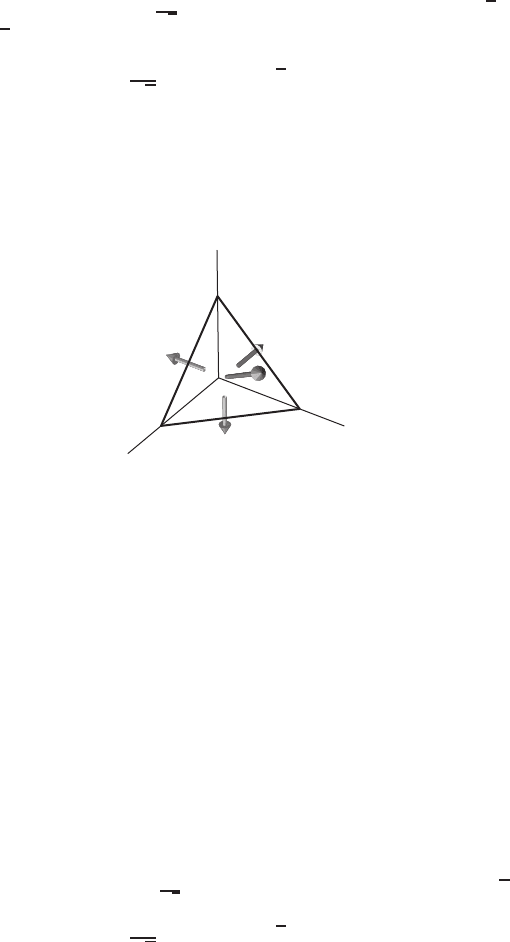
1730 Chapter Nineteen /SOLUTIONS
Next, we will find the flux out of the triangle in the yz plane. A unit vector normal to that plane, that points
negative, is equal to −~
i. The area of the face equals 0.5, therefore ~
A=−0.5
~
i . The flux through ~
Athen equals
(−~
i+ 2~
j+~
k)·(−0.5
~
i) = 0.5 + 0 + 0 = 0.5.
Last, we will find the flux out of the triangle with vertices (1,0,0),(0,1,0),(0,0,1). A unit vector normal to
that plane, that points positive, is equal to 1
√3(
~
i+~
j+~
k). The area of the face equals √3/2, since it is an equilateral
triangle with side √2. Therefore:
~
A=1
√3(
~
i+~
j+~
k)(√3/2) = 0.5(
~
i+~
j+~
k).
The flux through ~
Athen equals
(−~
i+ 2~
j+~
k)·(0.5
~
i+ 0.5~
j+ 0.5~
k) = −0.5 + 1 + 0.5 = 1.
The total flux out of the tetrahedron is −0.5−1 + 0.5 + 1 = 0. Therefore the flux equals zero.
x
y
z
Figure 19.6
(b) For any constant vector field ~v =a
~
i+b~
j+c~
k, we can find the flux out of the tetrahedron.
First we shall find the flux out of the triangle in the xy plane. A unit vector normal to that plane, that points
negative (because of the orientation of the face), is equal to −~
k. The area of the face equals 0.5, therefore ~
A=
−0.5~
k . The flux through ~
Athen equals
(a
~
i+b~
j+c~
k)·(−0.5~
k) = 0 + 0 −0.5 = −0.5c.
Next, we will find the flux out of the triangle in the xz plane. A unit vector normal to that plane, that points
negative, is equal to −~
j. The area of the face equals 0.5, therefore: ~
A=−0.5~
j . The flux through ~
Athen equals
(a
~
i+b~
j+c~
k)·(−0.5~
j) = 0 −0.5b+ 0 = −0.5b.
Next, we will find the flux out of the triangle in the yz plane. A unit vector normal to that plane, that points
negative, is equal to (−~
i). The area of the face equals 0.5, therefore ~
A=−0.5
~
i . The flux through ~
Athen equals
(a
~
i+b~
j+c~
k)·(−0.5
~
i) = −0.5a+ 0 + 0 = −0.5a.
Last, we will find the flux out of the triangle with vertices (1,0,0),(0,1,0),(0,0,1). A unit vector normal to
that plane, that points positive, is equal to 1
√3(
~
i+~
j+~
k). The area of the face equals √3/2, therefore:
~
A=1
√3(
~
i+~
j+~
k)(√3/2) = 0.5(
~
i+~
j+~
k).
The flux through ~
Athen equals
(a
~
i+b~
j+c~
k)·(0.5
~
i+ 0.5~
j+ 0.5~
k) = 0.5a+ 0.5b+ 0.5c.
The total flux out of the tetrahedron is −0.5c−0.5b−0.5a+ 0.5a+ 0.5b+ 0.5c= 0. Therefore, the flux is
equal to zero.
(c) The answers in (a) and (b) make sense because the vector field is constant, so it does not change as it enters through
one side of the tetrahedron, and exits the other side. Therefore the two cancel each other out,causing the flux to be
equal to zero.
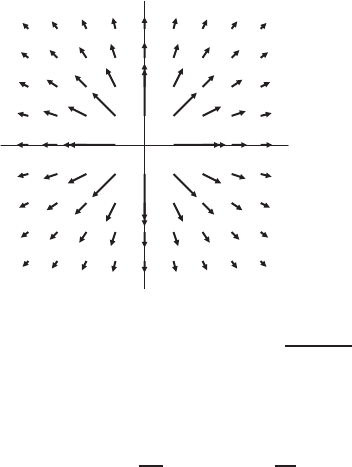
19.1 SOLUTIONS 1731
63. Since Pressure =Force/Area, we have
Force on a small patch with area ∆~
Aat point (x, y, z)≈P(x, y, z)k∆~
Ak.
This force is directed inward and normal to the surface, so the force is P(x, y, z)∆ ~
A(if Sis oriented with the inward
normal). For buoyancy, take the upward component of this force, so
Buoyancy force =P(x, y, z)∆ ~
A·~
k .
Then:
Total buoyancy = lim
k∆~
Ak→0X
s
P(x, y, z)∆ ~
A·~
k
=ZS
P(x, y, z)~
k·d~
A
=ZS
~
F·d~
A
64. (a) From Newton’s law of cooling, we know that the temperature gradient will be proportional to the heat flow. If the
constant of proportionality is kthen we have the equation ~
F=kgrad T. Since grad Tpoints in the direction of
increasing T, but heat flows toward lower temperatures, the constant kmust be negative.
(b) This form of Newton’s law of cooling is saying that heat will be flowing in the direction in which temperature is de-
creasing most rapidly, in other words, in the direction exactly opposite to grad T. This agrees with our intuition which
tells us that a difference in temperature causes heat to flow from the higher temperature to the lower temperature, and
the rate at which it flows depends on the temperature gradient.
(c) The rate of heat loss from Wis given by the flux of the heat flow vector field through the surface of the body. Thus,
Rate of heat
loss from W=Flux of ~
F
out of S=ZS
~
F·d~
A=kZS
(grad T)·d~
A
65. (a) Figure 19.7 shows the electric field ~
E. Note that ~
Epoints radially outward from the z-axis.
−2 2
−2
2
x
y
Figure 19.7
: The electric field in the xy-plane due to a line of positive charge uniformly
distributed along the z-axis: ~
E(x, y, 0) = 2λx
~
i+y~
j
x2+y2
(b) On the cylinder x2+y2=R2, the electric field ~
Epoints in the same direction as the outward normal ~n , and
k~
Ek=2λ
R2kx
~
i+y~
jk=2λ
R.

1732 Chapter Nineteen /SOLUTIONS
So
ZS
~
E·d~
A=ZS
~
E·~
n dA =ZSk~
EkdA =ZS
2λ
RdA
=2λ
RZS
dA =2λ
R·Area of S=2λ
R·2πRh = 4πλh,
which is positive, as we expected.
66. (a) The vector field ~
Bis sketched in Figure 19.8 for I > 0.
−2−4 2 4
−2
−4
2
4
x
y
Figure 19.8
(b) The disk Scan be parameterized as z=h(viewed as a constant function of xand y), for x, y in the region
{x2+y2≤a2}. Hence
ZS
~
B·d~
A=Z{x2+y2≤a2}
I
2π·−y~ı +x~
x2+y2·~
k dx dy = 0,
since ~ı ·~
k= 0 and ~ ·~
k= 0. The answer is as we would expect, since the vector field ~
Bis tangent to the surface
S, hence there is no flux through S.
(c) The flux of ~
Bthrough S2is given by RS2
~
B·d~
A . On S2we have
~
B(x, y, z) = I
2π·−y~ı
y2=−I
2πy~ı ,
and
d~
A=~n dA =−~ı dy dz
Hence,
ZS2
~
B·d~
A=Zh
0Zb
a
I
2π·(−~ı )
y·(−~ı )dy dz
=I
2πZh
0Zb
a
1
ydy dz
=I
2πZh
0
[ln |y|]b
adz
=I
2πZh
0
(ln |b| − ln |a|)dz
=I
2πhln
b
a.
This time we get a non-zero flux since the direction of ~
Bis everywhere parallel to the orientation of S2. For 0<
a < b the flux is positive since |b/a|>1and increases as the area S2increases. This is as Figure 19.8 would lead
us to expect. For a < b < 0, the flux is negative since |b/a|<1. If a < 0< b, the flux can be either positive or
negative.

19.1 SOLUTIONS 1733
67. (a) If ~r =x~ı +y~ +z~
kis the position vector of a point on the sphere, then
~
D(~r ) = 3zp
a5~r −p
a3~
k .
The second term is a constant vector field. Hence, by symmetry,
ZS−p
a3~
k·d~
A= 0.
(See the solution to Problem 54 on page 1727). Let us also apply a symmetry argument to
ZS
(3zp
a5~r )·d~
A .
We will show that the flux of ~
Dthrough the upper hemisphere H1equals minus the flux of ~
Dthrough the lower
hemisphere H2. The flux of ~
Dthrough H1and H2will be computed as limits of Riemann sums.
Consider a small patch P1in H1and call its reflection about the xy-plane P2. The contribution of P1to the flux
of ~
Dthrough Sis
3z1p
a5~r ·d~
A1=3z1p
a5~r ·Area(P1)~r
k~r k=3z1p
a4·Area(P1),
whereas the contribution from P2is 3z2p
a5~r ·d~
A1=3z2p
a4Area(P2).
But Area(P1) = Area(P2)and z2=−z1, so the contributions from P1and P2cancel each other. Dividing H1and
H2into symmetric patches as above, and taking the limit as the areas of the patches become smaller and smaller, one
gets ZH13zp
a5~r ·d~
A=−ZH23zp
a5~r ·d~
A .
i.e. ZS3zp
a5~r ·d~
A= 0.
Since we also know that ZS−p
a3~
k·d~
A= 0,
we can conclude that ZS
~
D·d~
A=0.
(b) By Gauss’s Law, ZS
~
E·d~
A= 4π(q−q) = 0,
which is the same as the flux of ~
Dthrough S.
Strengthen Your Understanding
68. The value of a flux integral is a scalar, not a vector.
69. The sign of a flux integral RS~
F·d~
Ais determined by the interaction between the vector field ~
Fand the oriented surface
S. It can not be determined from either one alone. For example, if Sis oriented in the +~
kdirection, then the flux through
Sof ~
F=~
kis positive and the flux through Sof ~
F=−kis negative.
70. The integral RS~
F·d~
Ais zero if the vector field ~
Fis tangent to the surface Sat every point of S. The displacement
vector ~
F=−~
i+~
jbetween the two points (1,0,0) and (0,1,0) in Sis tangent to S. Hence, with the constant vector
field ~
F=−~
i+~
jwe have RS~
F·d~
A= 0.
71. Let ~
F=z~
k, and let Sbe the square 0≤x≤1,0≤y≤1,z= 1, oriented upwards. The vector field is normal to
the surface, in the direction of the orientation, and has constant magnitude 1 on the surface, even though it has varying
magnitude elsewhere. ZS
~
Fd~
A=k~
Fk · Area of S= 1 ·1 = 1.

1734 Chapter Nineteen /SOLUTIONS
72. True. By definition, the flux integral is the limit of a sum of dot products, hence is a scalar.
73. False. ~
Ais perpendicular to the flat surface.
74. False. The flux integral measures the net flow through the surface. There could be as much flow into the sphere as out,
which would give a flux integral of zero. As an example, the constant field ~
F=~
ihas zero flux integral over the entire
sphere, yet is not the zero vector field.
75. True. The flow of this field is in the same direction as the orientation of the surface everywhere on the surface, so the flux
is positive.
76. True. The flow of this field is in the same direction as the orientation of the surface everywhere on the surface, so the flux
is positive.
77. True. Since the vector field is constant, the negative flux into the bottom of the cube is equal in magnitude to the positive
flux out of the top, so these cancel in the sum defining the flux integral. The other four faces of the cube each have zero
flux from the field, since the field is parallel to each of them.
78. True. Reversing the orientation on Sreplaces all of the area vectors ∆~
Ain the sum defining the flux integral with their
negatives, so that the flux integral over −Sis the negative of the flux integral over S.
79. False. There is no reason to expect a relationship between the flux integrals over S1and S2simply based on their relative
areas. The value of the flux integral over a surface depends both on the shape of the surface and the behavior of the vector
field at points on the surface. For example, let S1be the square 0≤x≤1,0≤y≤1, z = 0, oriented upward, and let
S2be the rectangle 0≤y≤1,0≤z≤2, x = 0 with positive orientation in the~
idirection. The area of S1= 1 and the
area of S2= 2.Then if ~
F=~
iwe have RS1
~
F·d~
A=0(since ~
Fis parallel to S1) and RS2
~
F·d~
A= 2. These values
do not satisfy 2RS1
~
F·d~
A=RS2
~
F·d~
A.
80. True. In the sum defining the flux integral for ~
F, we have terms like ~
F·∆~
A= (2 ~
G)·∆~
A= 2( ~
G·∆~
A). So each
term in the sum approximating the flux of ~
Fis twice the corresponding term in the sum approximating the flux of ~
G,
making the sum for ~
Ftwice that of the sum for ~
G. Thus the flux of ~
Fis twice the flux of ~
G.
81. False. The flux integral measures the net flow through the surface S. The vector field ~
Gcould be large in magnitude on
S(larger than ||~
F||), but be parallel to the surface S, and so contribute nothing to the flux. Put another way, a “small”
vector field, flowing directly across S, can have greater flux than a much “larger” field flowing parallel to S.
For example, take Sto be the square 0≤x≤1,0≤y≤1, z = 0, oriented upward. Then if ~
F=~
kand ~
G= 5
~
i,
the flux integrals have values RS~
F·d~
A=1and RS~
G·d~
A= 0 (since ~
Gis parallel to S). Thus RS~
F·d~
A > RS~
G·d~
A ,
but ||~
F|| = 1 <5 = ||~
G||.
82. For (a), we want the vector field with the largest~
icomponent so ~
F1.
For (b), we want the vector field with the largest~
icomponent so ~
F1.
For (c), we want the vector field with the most negative ~
kcomponent, so ~
F4.
For (d), we want the vector field with the most negative ~
kcomponent, so ~
F4.
For (e), we want the vector field with the largest ~
jcomponent so ~
F3.
Solutions for Section 19.2
Exercises
1. We have
d~
A=−fx
~
i−fy~
j+~
kdx dy =−3
~
i+ 5~
j+~
kdx dy.
2. We have
d~
A=−fx
~
i−fy~
j+~
kdx dy =−8
~
i−7~
j+~
kdx dy.
3.We have
d~
A=−fx
~
i−fy~
j+~
kdx dy =−4x
~
i+6y~
j+~
kdx dy.
4. We have
d~
A=−fx
~
i−fy~
j+~
kdx dy =−y~
i+ (−x−2y)~
j+~
kdx dy.

19.2 SOLUTIONS 1735
5. We have
d~
A=−fx
~
i−fy~
j+~
kdx dy =−2
~
i+ 3~
j+~
kdx dy.
We have ~
F·d~
A= (−20 + 60 + 30)dx dy = 70 dx dy.
The flux of ~
Fthrough the surface Sis given by
ZS
~
F·d~
A=Z3
−2Z5
0
70dy dx.
6. We have
d~
A=−fx
~
i−fy~
j+~
kdx dy =4
~
i−10~
j+~
kdx dy.
We have ~
F·d~
A= (4z−10x+y)dx dy.
The flux of ~
Fthrough the surface Sis given by
ZS
~
F·d~
A=Z8
0Z4
0
(4z−10x+y)dx dy.
7. We have
d~
A=−fx
~
i−fy~
j+~
kdx dy =sin x
~
i−2cos 2y~
j+~
kdx dy.
We have ~
F·d~
A= (yz sin x−2xy cos 2y+xy)dx dy.
The region Ris a triangle bounded by the x-axis, the y-axis, and the line y= 5 −x. Thus, Ris described by the
inequalities 0≤y≤5−x,0≤x≤5. The flux of ~
Fthrough the surface Sis given by
ZS
~
F·d~
A=Z5
0Z5−x
0
(yzsin x−2xy cos 2y+xy)dy dx.
8. We have
d~
A=−fx
~
i−fy~
j+~
kdx dy =−e3y
~
i−3xe3y~
j+~
kdx dy.
We have
~
F·d~
A=−3xe3ycos(x+ 2y)dx dy.
The region Ris the part of the disk x2+y2≤52where x≥0and y≥0. Thus, Ris described by the inequalities
0≤y≤√52−x2,0≤x≤5. The flux of ~
Fthrough the surface Sis given by
ZS
~
F·d~
A=Z5
0Z√25−x2
0−3xe3ycos(x+ 2y)dy dx.
9. We have
d~
A=−fx
~
i−fy~
j+~
kdx dy =−4
~
i+ 2~
j+~
kdx dy.
Hence ~
F·d~
A= (−12 −4 + 6)dx dy =−10 dx dy.
The flux of ~
Fthrough the surface Sis given by
ZS
~
F·d~
A=Z5
0Z10
0−10dy dx =−500.
10. We have
d~
A=−fx
~
i−fy~
j+~
kdx dy =−y~
i−x~
j+~
kdx dy.
Since z=xy we have
~
F·d~
A= (−y+ 2x+xy)dx dy.
The flux of ~
Fthrough the surface Sis given by
ZS
~
F·d~
A=Z10
0Z10
0
(−y+2x+xy)dx dy
=Z10
0
100 + 40y dy = 3000.

1736 Chapter Nineteen /SOLUTIONS
11. We have
d~
A=−fx
~
i−fy~
j+~
kdx dy =−2x
~
i−2~
j+~
kdx dy.
Since z=x2+ 2yhave
~
F·d~
A= (−2xcos y−2x2−4y+ 1) dx dy.
The flux of ~
Fthrough the surface Sis given by
ZS
~
F·d~
A=Z1
0Z1
0
(−2xcos y−2x2−4y+ 1)dx dy
=Z1
0
1
3−4y−cos y dy =−5
3−sin 1 = −2.508.
12. We have
d~
A=−fx
~
i−fy~
j+~
kdx dy =−~
i−~
j+~
kdx dy.
Since z=x+y+ 2 have ~
F·d~
A= (y+ 2) dx dy.
The (x, y)values for points on Sare in the triangle with vertices (−1,0),(1,0),(0,1). The edges of the triangle are
given by the x-axis, y= 1 + xand y= 1 −x. For this region, it makes sense to integrate on xfirst, so we describe the
region by the inequalities y−1≤x≤1−y,0≤y≤1. The flux of ~
Fthrough the surface Sis
ZS
~
F·d~
A=Z1
0Z1−y
y−1
(y+2) dx dy
=Z1
0
4−2y−2y2dy=7
3.
13. Since the cylinder radius is 10, we have
d~
A= 10 cos θ
~
i+sin θ~
jdz dθ.
Hence ~
F·d~
A= 10 (cos θ+ 2 sin θ)dz dθ.
The θz-region corresponding to Sis given by 0≤θ≤π/2,0≤z≤5. The flux of ~
Fthrough the surface Sis given by
ZS
~
F·d~
A=Zπ/2
0Z5
0
10 (cos θ+ 2 sin θ)dz dθ.
14. Since the cylinder radius is 10, we have
d~
A= 10 cos θ
~
i+sin θ~
jdz dθ.
Using x= 10 cos θand y= 10 sin θwe have
~
F= 10 cos θ
~
i+ 20 sin θ~
j+ 3z~
k .
Hence ~
F·d~
A= 10 10 cos2θ+20 sin2θdz dθ.
The θz-region corresponding to Sis given by 0≤θ≤2π,0≤z≤5. The flux of ~
Fthrough the surface Sis given by
ZS
~
F·d~
A=Z2π
0Z5
0
10 10 cos2θ+ 20 sin2θdz dθ.
19.2 SOLUTIONS 1737
15. Since the cylinder radius is 6, we have
d~
A= 6 cos θ
~
i+ sin θ~
jdz dθ.
Using x= 6 cos θand y= 6 sin θwe have
~
F=z2
~
i+e6 cos θ~
j+~
k .
Hence
~
F·d~
A=6z2cos θ+ 6 sin θe6 cos θdz dθ.
The surface Sis the part of the cylinder x2+y2= 62that is inside the sphere x2+y2+z2= 102. The cylinder and the
sphere intersect at points where z2= 102−62= 64, where z= 8 or z=−8. Therefore, the θz-region corresponding
to Sis given by 0≤θ≤2π,−8≤z≤8. The flux of ~
Fthrough the surface Sis given by
ZS
~
F·d~
A=Z2π
0Z8
−86z2cos θ+ 6 sin θe6 cos θdz dθ.
16. Since the cylinder radius is 2, we have
d~
A= 2 cos θ
~
i+sin θ~
jdz dθ.
Using x= 2 cos θand y= 2 sin θwe have
~
F= 8zcos2θsin θ~
j+z3~
k .
Hence ~
F·d~
A= 16zcos2θsin2θ dz dθ.
The surface Sis the part of the cylinder x2+y2= 22that is between the xy-plane z= 0 and the paraboloid z=x2+y2.
The cylinder and the paraboloid intersect at points where z= 22. Therefore, the θz-region corresponding to Sis given
by 0≤θ≤2π,0≤z≤4. The flux of ~
Fthrough the surface Sis given by
ZS
~
F·d~
A=Z2π
0Z4
0
16zcos2θsin2θ dz dθ.
17. Since the cylinder radius is 5, we have
d~
A= 5 cos θ
~
i+sin θ~
jdz dθ.
Hence ~
F·d~
A= 5zsin θ dz dθ.
The θz-region corresponding to S, the part of the cylinder with y≥0and 0≤z≤20, is given by 0≤θ≤π,
0≤z≤20. The flux of ~
Fthrough the surface Sis given by
ZS
~
F·d~
A=Zπ
0Z20
0
5zsin θ dz dθ =Zπ
0
1000 sin θ dθ = 2000.
18. Since the cylinder radius is 10, we have
d~
A= 10 cos θ
~
i+sin θ~
jdz dθ.
Using x= 10 cos θand y= 10 sin θwe have
~
F= 10 sin θ
~
i+ 10zcos θ~
k .
Hence ~
F·d~
A= 100 cos θsin θ dz dθ.
The surface Sis the part of the cylinder with x≥0,y≥0and 0≤z≤3, so the θz-region corresponding to Sis given
by 0≤θ≤π/2,0≤z≤3. The flux of ~
Fthrough the surface Sis given by
ZS
~
F·d~
A=Zπ/2
0Z3
0
100 cos θsin θ dz dθ
=Zπ/2
0
300 cos θsin θ dθ
= 150 sin2θ|π/2
θ=0 = 150.
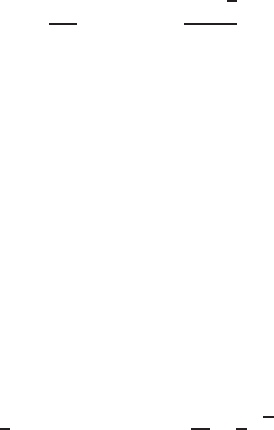
1738 Chapter Nineteen /SOLUTIONS
19. Since the cylinder radius is 2, we have
d~
A= 2 cos θ
~
i+ sin θ~
jdz dθ.
Using x= 2 cos θand y= 2 sin θwe have
~
F= 4zcos θsin θ~
j+ 2ezcos θ~
k .
Hence ~
F·d~
A= 8zcos θsin2θ dz dθ.
The surface Sis the part of the cylinder with 0≤y≤xand 0≤z≤10, so the θz-region corresponding to Sis given
by 0≤θ≤π/4,0≤z≤10. The flux of ~
Fthrough the surface Sis given by
ZS
~
F·d~
A=Zπ/4
0Z10
0
8zcos θsin2θ dz dθ
=Zπ/4
0
400 cos θsin2θ dθ
=400
3sin3θ|π/4
θ=0 =100√2
3.
20. Since the cylinder radius is 1, we have
d~
A=cos θ
~
i+sin θ~
jdz dθ.
Using x= cos θand y= sin θwe have ~
F= cos θsin θ
~
i+ 2z~
j .
Hence
~
F·d~
A=cos2θsin θ+ 2zsin θdz dθ.
The surface Sis the part of the cylinder with x≥0,0≤y≤1/2and 0≤z≤2, so the θz-region corresponding to Sis
given by 0≤θ≤π/6,0≤z≤2. The flux of ~
Fthrough the surface Sis given by
ZS
~
F·d~
A=Zπ/6
0Z2
0cos2θsin θ+ 2zsin θdz dθ
=Zπ/6
0
2 cos2θsin θ+ 4 sin θ dθ
=−2
3cos3θ−4 cos θ|π/6
θ=0 =14
3−9
4√3 = 0.770.
21. Since the sphere radius is 10, we have
d~
A= 102sin φcos θ
~
i+ sin φsin θ~
j+ cos φ~
ksin φ dφ dθ.
Hence ~
F·d~
A= 100 (sin φcos θ+ 2 sin φsin θ+ 3 cos φ) sin φ dφ dθ.
The θφ-region corresponding to S, the upper hemisphere z≥0, is given by 0≤θ≤2π,0≤φ≤π/2. The flux of ~
F
through the surface Sis given by
ZS
~
F·d~
A=Z2π
0Zπ/2
0
100 (sin φcos θ+ 2 sin φsin θ+ 3 cos φ) sin φ dφ dθ.

19.2 SOLUTIONS 1739
22. Since the sphere radius is 5, we have
d~
A= 52sin φcos θ
~
i+ sin φsin θ~
j+ cos φ~
ksin φ dφ dθ.
Using x= 5 sin φcos θ,y= 5 sin φsin θand z= 5 cos φwe have
~
F= 5 sin φcos θ
~
i+ 10 sin φsin θ~
j+ 15 cos φ~
k .
Hence ~
F·d~
A= 525 sin2φcos2θ+ 10 sin2φsin2θ+ 15 cos2φsin φ dφ dθ.
The θφ-region corresponding to S, the entire sphere, is given by 0≤θ≤2π,0≤φ≤π. The flux of ~
Fthrough the
surface Sis given by
ZS
~
F·d~
A=Z2π
0Zπ
0
255 sin2φcos2θ+ 10 sin2φsin2θ+ 15 cos2φsin φ dφ dθ.
23. Since the sphere radius is 2, we have
d~
A= 22sin φcos θ
~
i+ sin φsin θ~
j+ cos φ~
ksin φ dφ dθ.
Using z= 2 cos φwe have ~
F= 4 cos2φ
~
i .
Hence
~
F·d~
A= 16 cos2φsin2φcos θ dφ dθ.
The θφ-region corresponding to S, the part of the sphere with x≥0, is given by −π/2≤θ≤π/2,0≤φ≤π. The
flux of ~
Fthrough the surface Sis given by
ZS
~
F·d~
A=Zπ/2
−π/2Zπ
0
16 cos2φsin2φcos θ dφ dθ.
24. Since the sphere radius is 3, we have
d~
A= 32sin φcos θ
~
i+ sin φsin θ~
j+ cos φ~
ksin φ dφ dθ.
Using x= 3 sin φcos θwe have
~
F=e3 sin φcos θ~
k .
Hence
~
F·d~
A= 9 cos φsin φe3 sin φcos θdφ dθ.
The θφ-region corresponding to S, the part of the sphere with y≥0and z≤0, is given by 0≤θ≤π,π/2≤φ≤π.
The flux of ~
Fthrough the surface Sis given by
ZS
~
F·d~
A=Zπ
0Zπ
π/2
9 cos φsin φe3 sin φcos θdφ dθ.
25. Since the sphere radius is 20, we have
d~
A= 202sin φcos θ
~
i+ sin φsin θ~
j+ cos φ~
ksin φ dφ dθ.
Using z= 20 cos φwe have ~
F= 20 cos φ
~
i .
Hence ~
F·d~
A= 8000 sin2φcos φcos θ dφ dθ.
The θφ-region corresponding to S, the part of the sphere where x≥0,y≥0and z≥0, is given by 0≤θ≤π/2,
0≤φ≤π/2. The flux of ~
Fthrough the surface Sis given by
ZS
~
F·d~
A=Zπ/2
0Zπ/2
0
8000 sin2φcos φcos θ dφ dθ
=Zπ/2
0
8000
3cos θ dθ =8000
3.

1740 Chapter Nineteen /SOLUTIONS
26. Since the sphere radius is 4, we have
d~
A= 42sin φcos θ
~
i+ sin φsin θ~
j+ cos φ~
ksin φ dφ dθ.
Using x= 4 sin φcos θ,y= 4 sin φsin θand z= 4 cos φwe have
~
F= 4 sin φsin θ
~
i−4 sin φcos θ~
j+ 4 cos φ~
k .
Hence ~
F·d~
A= 64 cos2φsin φ dφ dθ.
The θφ-region corresponding to the entire sphere is given by 0≤θ≤2π,0≤φ≤π. The flux of ~
Fthrough the surface
Sis given by
ZS
~
F·d~
A=Z2π
0Zπ
0
64 cos2φsin φ dφ dθ
=Z2π
0−64
3cos3φ|π
φ=0 dθ
=Z2π
0
128
3dθ =256
3π.
27. Since the sphere radius is 1, we have
d~
A=sin φcos θ
~
i+ sin φsin θ~
j+ cos φ~
ksin φ dφ dθ.
Using x= sin φcos θand y= sin φsin θwe have
~
F= sin φcos θ
~
i+ sin φsin θ~
j .
Hence
~
F·d~
A=sin3φcos2θ+ sin3φsin2θdφ dθ = sin3φ dφ dθ.
The θφ-region corresponding to region above the cone φ=π/4is given by 0≤θ≤2π,0≤φ≤π/4. The flux of ~
F
through the surface Sis given by
ZS
~
F·d~
A=Zπ/4
0Z2π
0
sin3φ dθ dφ = 2πZπ/4
0
sin3φ dφ
= 2πZπ/4
0
sin φ(1 −cos2φ)dφ
= 2π(−cos φ+1
3cos3φ)|π/4
φ=0
=8−5√2
6π= 0.486.
28. We find the equation for the plane Sin the form z=f(x, y). The rectangle lies in the plane z+ 2y= 4 we have
z=f(x, y) = 4 −2y.
Thus, we have
d~
A= (−fx
~
i−fy~
j+~
k)dx dy = (0
~
i+ 2~
j+~
k)dx dy = (2~
j+~
k)dx dy.
The flux integral is therefore
ZS
~
F·d~
A=Z2
0Z2
0
(4−2y)~
k·(2~
j+~
k)dx dy =Z2
0Z2
0
4−2y dx dy = 8.
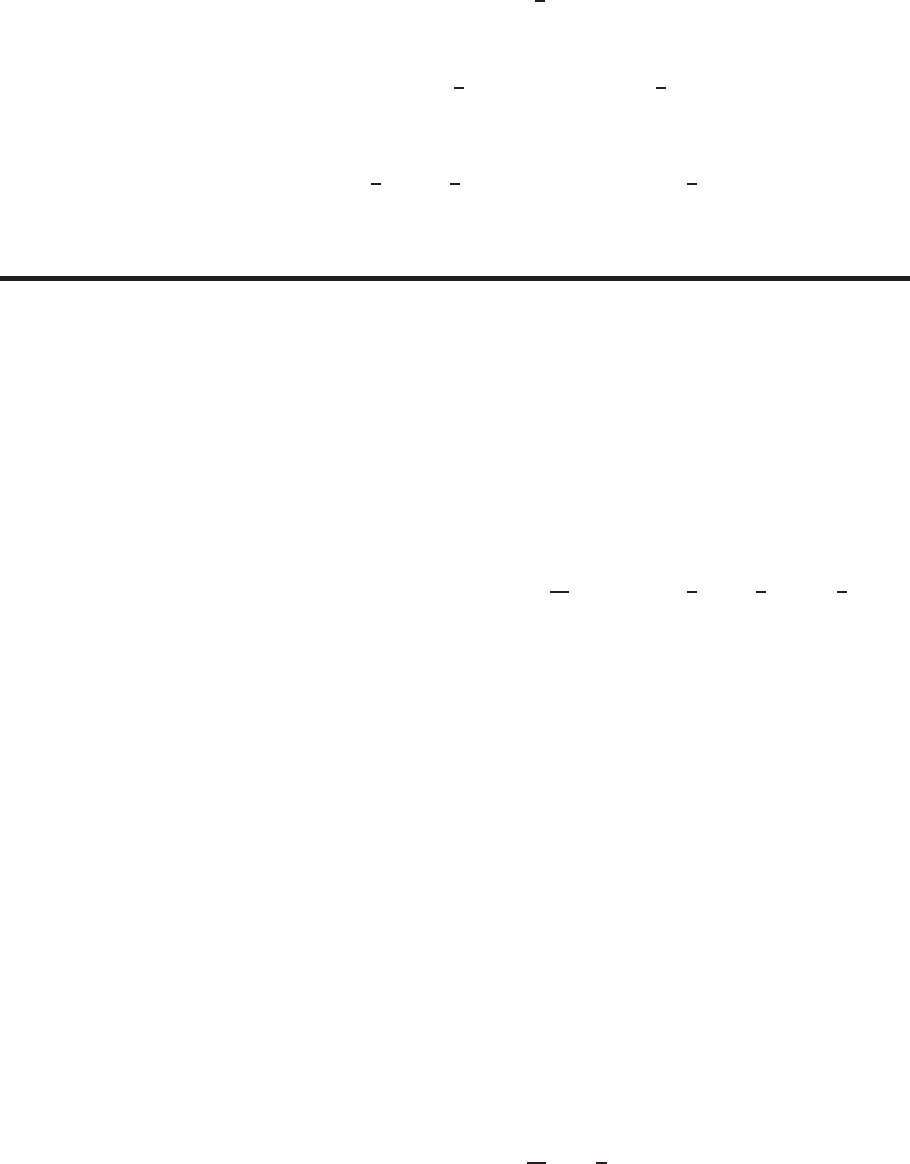
19.2 SOLUTIONS 1741
29. We find the equation for the plane Sin the form z=f(x, y). The rectangle lies in the plane 3x+ 2z= 6 so we have
z=f(x, y) = 3 −3
2x.
Thus, we have
d~
A= (−fx
~
i−fy~
j+~
k)dx dy =3
2~
i+ 0~
j+~
kdx dy =3
2~
i+~
kdx dy.
The flux integral is therefore
ZS
~
F·d~
A=Z2
0Z2
03−3
2x~
k·3
2~
i+~
kdx dy =Z2
0Z2
0
3−3
2x dx dy = 6.
Problems
30. We find the equation for the plane Sin the form z=f(x, y). We have
z=f(x, y) = 1 −x−y.
Thus, we have
d~
A= (−fx
~
i−fy~
j+~
k)dy dx = (−(−1)
~
i−(−1)~
j+~
k)dy dx = (
~
i+~
j+~
k)dy dx.
The surface Sintersects the xy-plane in the line x+y= 1, so the region Rin the xy-plane below Sis bounded by the
x-axis, y-axis, and the line y= 1 −x. The flux integral is, therefore,
ZS
~
F·d~
A=Z1
0Z1−x
0
(1−x−y)~
k·(
~
i+~
j+~
k)dy dx
=Z1
0Z1−x
0
(1−x−y)dy dx =Z1
0
y−xy −y2
2
1−x
0
dx =Z1
0
1
2−x+1
2x2dx =1
6.
31. Using z=f(x, y) = x+y, we have d~
A= (−~
i−~
j+~
k)dx dy. As Sis oriented upward, we have
ZS
~
F·d~
A=Z3
0Z2
0
((x−y)
~
i+ (x+y)~
j+ 3x~
k)·(−~
i−~
j+~
k)dxdy
=Z3
0Z2
0
(−x+y−x−y+ 3x)dxdy =Z3
0Z2
0
x dxdy = 6.
32. Writing the surface Sas z=f(x, y) = −y+ 1, we have
d~
A= (−fx
~
i−fy~
j+~
k)dxdy.
Thus,
ZS
~
F·d~
A=ZR
~
F(x, y, f (x, y)) ·(−fx
~
i−fy~
j+~
k)dxdy
=Z1
0Z1
0
(2x~
j+y~
k)·(~
j+~
k)dxdy
=Z1
0Z1
0
(2x+y)dxdy =Z1
0
(x2+xy)
1
0
dy
=Z1
0
(1 + y)dy = (y+y2
2)
1
0
=3
2.
1742 Chapter Nineteen /SOLUTIONS
33. Writing the surface Sas z=f(x, y) = y2+ 5, we have
d~
A= (−fx
~
i+−fy~
j+~
k)dxdy.
Thus,
ZS
~
F·d~
A=ZR
~
F(x, y, f (x, y)) ·(−fx
~
i−fy~
j+~
k)dxdy
=ZR
(−y~
j+(y2+ 5)~
k)·(−2y~
j+~
k)dxdy
=Z1
0Z1
−2
(3y2+ 5) dxdy =Z1
0
(9y2+ 15) dy
= (3y3+ 15y)
1
0
= 18.
34. One the surface Swe have z=−y+ 1 and d~
A= (−zx
~
i−zy~
j+~
k)dx dy = (~
j+~
k)dx dy. The flux is
ZS
~
F·d~
A=Z1
0Z1
0
((ln(x2)
~
i+ex~
j+ cos(1 −(−y+ 1))~
k)·(~
j+~
k)dx dy
=Z1
0Z1
0
(ex+ cos y)dx dy =Z1
0
(ex+xcos y)
1
0
dy
=Z1
0
(e+cos y−1) dy = (ye + sin y−y)
1
0
=e+ sin 1 −1.
35. On the curved sides of the cylinder, the ~
kcomponent of ~
Fdoes not contribute to the flux. Since the~
iand ~
jcomponents
are constant, these components contribute 0 to the flux on the entire cylinder. Therefore the only nonzero contribution to
the flux results from the ~
kcomponent through the top, where z= 2 and d~
A=~
k dA, and from the ~
kcomponent through
the bottom, where z=−2and d~
A=−~
k dA:
Flux =ZTop
~
F·d~
A+ZBottom
~
F·d~
A
=ZTop
2~
k·~
kdA +ZBottom
(−2~
k)·(−~
k dA)
= 4 ZTop
dA = 4 ·Area of top = 4 ·π(32) = 36π.
36. On the curved side of the cylinder, only the components x
~
i+z~
kcontribute to the flux. Since x
~
i+z~
kis perpendicular
to the curved surface and ||x
~
i+z~
k|| = 2 there (because the cylinder has radius 2), we have
Flux through sides = 2 ·Area of curved surface = 2 ·2π·2·6 = 48π.
On the flat ends, only y~
jcontributes to the flux. On one end, y= 3 and d~
A=~
j dA; on the other end, y=−3and
d~
A=−~
j dA. Thus
Flux through ends =Flux through top +Flux through bottom
= 3~
j·~
j π(22) + (−3~
j)·(−~
j π(22)) = 24π.
So,
Total flux = 48π+ 24π= 72π.
37. Writing the surface Sas z=f(x, y) = −2x−4y+ 1, we have
d~
A= (−fx
~
i−fy~
j+~
k)dxdy.
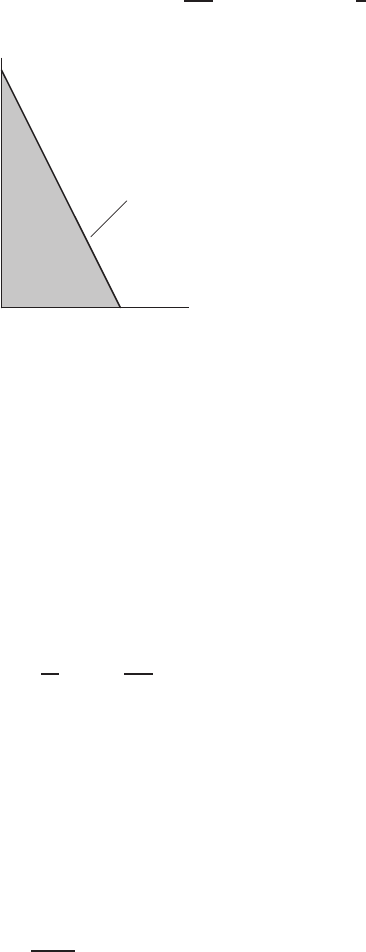
19.2 SOLUTIONS 1743
With Ras shown in Figure 19.9, we have
ZS
~
F·d~
A=ZR
~
F(x, y, f (x, y)) ·(−fx
~
i−fy~
j+~
k)dxdy
=ZR
(3x
~
i+y~
j+ (−2x−4y+ 1)~
k)·(2
~
i+ 4~
j+~
k)dxdy
=ZR
(4x+ 1) dxdy =Z1
0Z−2x+2
0
(4x+ 1) dydx
=Z1
0
(4x+ 1)(−2x+ 2) dx
=Z1
0
(−8x2+6x+ 2) dx = (−8x3
3+ 3x2+ 2x)
1
0
=7
3.
y
x
R
1
2
✠
y=−2x+ 2
Figure 19.9
38. Writing the surface Sas z=f(x, y) = 25 −x2−y2, we have
d~
A= (−fx
~
i−fy~
j+~
k)dxdy.
Thus,
ZS
~
F·d~
A=ZR
~
F(x, y, f (x, y)) ·(−fx
~
i−fy~
j+~
k)dxdy
=ZR
(x
~
i+y~
j)·(2x
~
i+ 2y~
j+~
k)dxdy
=ZR
2(x2+y2)dxdy =Z2π
0Z5
0
2r2rdrdθ
=Z2π
0
r4
2
5
0
dθ =625
2(2π) = 625π.
39. Writing the surface Sas z=f(x, y) = 25 −x2−y2, we have
d~
A= (−fx
~
i−fy~
j+~
k)dxdy = (2x
~
i+ 2y~
j+~
k)dxdy.
Thus
ZS
~
F·d~
A=ZR
cos(x2+y2)~
k·(2x
~
i+ 2y~
j+~
k)dxdy
=ZR
cos(x2+y2)dxdy =Z2π
0Z5
0
cos r2·r drdθ
=Z2π
0
sin r2
2
5
0
dθ =πsin 25.
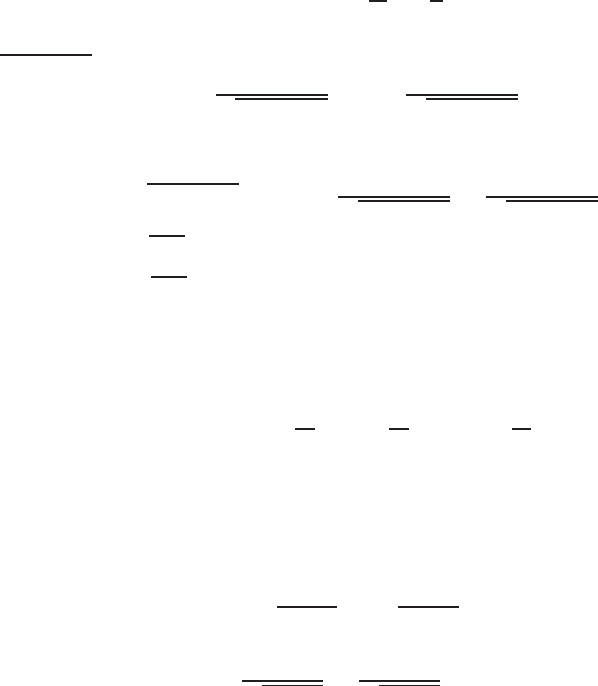
1744 Chapter Nineteen /SOLUTIONS
40. Using z= 1 −x−y, the upward pointing area element is d~
A= (
~
i+~
j+~
k)dx dy, so the downward one is
d~
A= (−~
i−~
j−~
k)dx dy. Since Sis oriented downward, we have
ZS
~
F·d~
A=ZS
(x
~
i+y~
j+z~
k)·d~
A
=Z3
0Z2
0
(x
~
i+y~
j+(1 −x−y)~
k)·(−~
i−~
j−~
k)dxdy
=Z3
0Z2
0
(−x−y−1 + x+y)dxdy =−6.
41. Using z=x2+y2, we find that the upward pointing area element is d~
A= (−2x
~
i−2y~
j+~
k)dx dy. Since Sis
oriented downward, we have d~
A= (2x
~
i+ 2y~
j−~
k)dx dy, so
ZS
~
F·d~
A=ZS
(x
~
i+y~
j+z~
k)·d~
A
=ZDisk
(x
~
i+y~
j+(x2+y2)~
k)·(2x
~
i+ 2y~
j−~
k)dx dy
=ZDisk
(2x2+ 2y2−x2−y2)dx dy =ZDisk
(x2+y2)dx dy
=Z2π
0Z1
0
r2rdr dθ = 2π·r4
4
1
0
=π
2.
42. Here z=p9−x2−y2, so
zx=−x
p9−x2−y2zy=−y
p9−x2−y2.
The flux integral is given by
ZS
~
F·d~
A=ZSxp9−x2−y2
~
i+y~
k· x
p9−x2−y2
~
i+y
p9−x2−y2
~
j+~
k!dxdy
=Z3
−3Z√9−x2
−√9−x2
(x2+y)dydx
Changing to polar coordinates gives
ZS
~
F·d~
A=Z2π
0Z3
0
(r2cos2θ+rsin θ)rdrdθ
=Z2π
081
4cos2θ+27
3sin θdθ =81
4π.
43. We have 0≤z≤6so 0≤x2+y2≤36. Let Rbe the disk of radius 6in the xy-plane centered at the origin. Because
of the cone’s point, the flux integral is improper; however, it does converge. We have
ZS
~
F·d~
A=ZR
~
F(x, y, f (x, y)) ·(−fx
~
i−fy~
j+~
k)dxdy
=ZR
(−xpx2+y2
~
i−ypx2+y2~
j+ (x2+y2)~
k)
· −x
px2+y2
~
i−y
px2+y2
~
j+~
k!dxdy
=ZR
2(x2+y2)dxdy
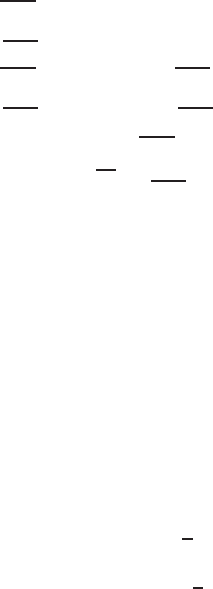
19.2 SOLUTIONS 1745
= 2 Z6
0Z2π
0
r3dθdr
= 4πZ6
0
r3dr = 1296π.
44. Since y=f(x, z) = x2+z2, we have
d~
A= (−fx
~
i+~
j−fz~
k)dxdz = (−2x
~
i+~
j−2z~
k)dxdz.
Thus, substituting y=x2+z2into ~
F, we have
ZS
~
F·d~
A=Zx2+z2≤1
((x2+z2)
~
i+~
j−xz~
k)·(−2x
~
i+~
j−2z~
k)dxdz
=Zx2+z2≤1
(−2x3−2xz2+ 1 + 2xz2)dxdz
=Z1
−1Z√1−z2
−√1−z2
(1 −2x3)dxdz
=Z1
−1Z√1−z2
−√1−z2
dxdz −Z1
−1Z√1−z2
−√1−z2
2x3dxdz
=Area of disk −Z1
−1
x4
2
√1−z2
−√1−z2
dz =π−0 = π
45. The plane through the points (1,0,0),(0,1,0), and (0,0,1) is given by x+y+z= 1, so Sis the part of the graph of
z=f(x, y) = 1 −x−yabove the region Rin the xy-plane where x≥0,y≥0, and x+y≤1. Thus
ZS
~
F·d~
A=ZR
~
F(x, y, f (x, y)) ·(−fx
~
i−fy~
j+~
k)dx dy
=ZR
(x2
~
i+y2~
j+(1 −x−y)2~
k)·(
~
i+~
j+~
k)dx dy
=ZR
(x2+y2+ (1 −x−y)2)dx dy
=Z1
0Z1−x
0
(1 + 2x2+ 2y2−2x−2y+ 2xy)dy dx
=Z1
0
[(1 −x) + 2x2(1 −x) + 2
3(1 −x)3−2x(1 −x)
−(1 −x)2+x(1 −x)2]dx =1
4.
46. Since the radius of the cylinder is 1, using cylindrical coordinates we have
d~
A= (cos θ
~
i+ sin θ~
j)dθdz.
Thus,
ZS
~
F·d~
A=Z6
0Z2π
0
(cos θ
~
i+ sin θ~
j)·(cos θ
~
i+ sin θ~
j)dθ dz
=Z6
0Z2π
0
1dθ dz = 12π.
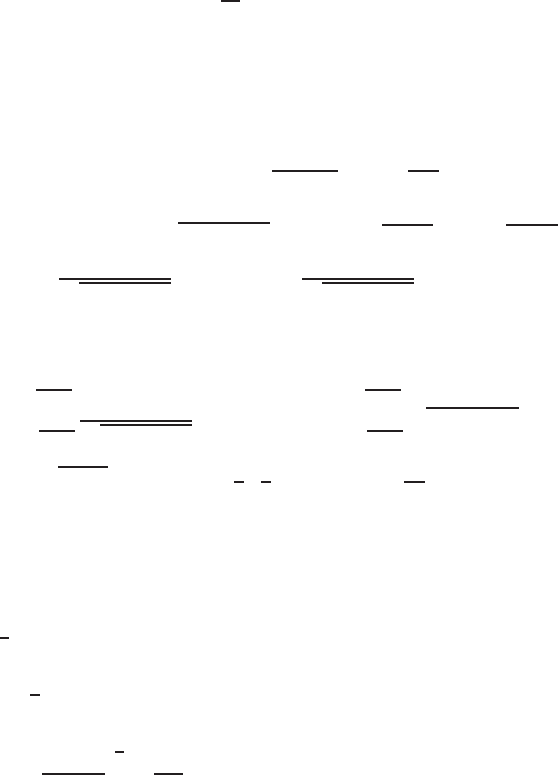
1746 Chapter Nineteen /SOLUTIONS
47. Since the radius of the cylinder is 1, using cylindrical coordinates we have d~
A= (cos θ
~
i+ sin θ~
j)dθdz. Thus,
ZS
~
F·d~
A=Z6
0Z2π
0
(zcos θ
~
i+zsin θ~
j+z3~
k)·(cos θ
~
i+ sin θ~
j)dθ dz
=Z6
0Z2π
0
zdθ dz = 2πz2
2
6
0
= 36π.
48. The flux of ~
Fthrough Sis given by
ZS
~
F·d~
A=Z2π
0Zπ/2
0
(2 cos φ~
k)·(sin φcos θ
~
i+ sin φsin θ~
j+ cos φ~
k)22sin φ dφ dθ
=Z2π
θ=0 Zπ/2
φ=0
8 sin φcos2φdφdθ = 16π(−cos3φ
3)
π/2
φ=0
=16π
3.
49. A parameterization for the surface Sis given by z=p1−x2−y2over Rfor −√1−x2≤y≤√1−x2,−1≤x≤
1. Thus
zx=−x
p1−x2−y2and zy=−y
p1−x2−y2,
so
ZS
~
F·d~
A=ZR
(y~
i−x~
j+z~
k)·(−zx
~
i−zy~
j+~
k)dx dy
=Z1
−1Z√1−x2
−√1−x2
yx −xy
p1−x2−y2+z dx dy =Z1
−1Z√1−x2
−√1−x2p1−x2−y2dy dx
=Z2π
0Z1
0p1−r2r dr dθ = 2πh−1
2·2
3(1 −r2)3/2i1
0
=2π
3.
50. Since the radius of the sphere is 5, using spherical coordinates we have
d~
A= (sin φcos θ
~
i+ sin φsin θ~
j+ cos φ~
k)25 sin φ dθ dφ.
Thus,
ZS
~
F·d~
A=Zπ
2
0Z2π
0
(25 cos2φ~
k)·(sin φcos θ
~
i+ sin φsin θ~
j+ cos φ~
k)25 sin φ dθ dφ
= 625 Zπ
2
0Z2π
0
cos3φsin φ dθdφ
=−1250π(cos φ)4
4
π
2
0
=625
2π.
51. Since the radius of the sphere is a, using spherical coordinates we have
d~
A= (sin φcos θ
~
i+ sin φsin θ~
j+ cos φ~
k)a2sin φ dφ dθ.
Thus,
ZS
~
F·d~
A=Z2π
0Zπ
0
(asin φcos θ
~
i+asin φsin θ~
j+acos φ~
k)·
(sin φcos θ
~
i+ sin φsin θ~
j+ cos φ~
k)a2sin φ dφ dθ
=a3Z2π
0Zπ
0
sin φ dφ dθ
= 2πa3Zπ
0
sin φ dφ = (2πa3)(2) = 4πa3.
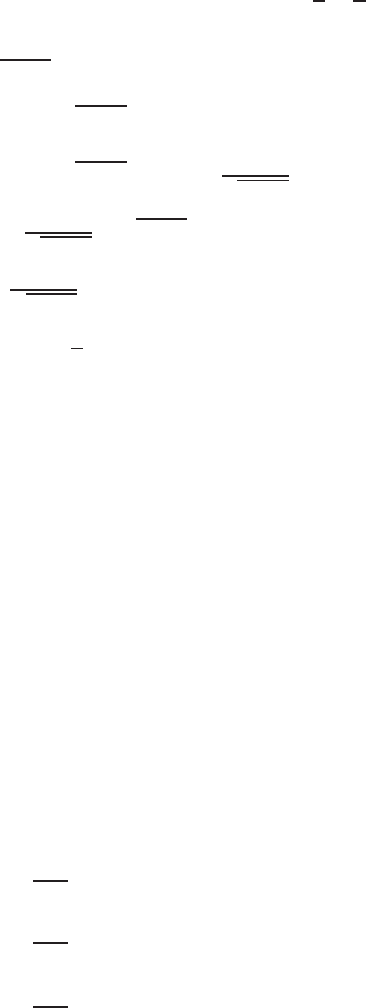
19.2 SOLUTIONS 1747
52. The ~
k-component of ~
Fdoes not contribute to the flux as it is perpendicular to the surface. The vector field x
~
i+y~
jis
everywhere perpendicular to Sand has constant magnitude ||x2+y2|| = 1 on the surface S. Thus
ZS
~
F·d~
A=ZS
(x
~
i+y~
j)·d~
A=1·Area of S= 1 π
2=π
2.
Alternatively, the flux can be computed by integrating with respect to xand z, treating yas a function of xand z. A
parameterization of Sis given by y=√1−x2,0≤x≤1,0≤y≤1,0≤z≤1. Thus,
ZS
~
F·d~
A=Z1
0Z1
0
(x
~
i+p1−x2~
j+z~
k)·(−yx
~
i+~
j−yz~
k)dx dz
=Z1
0Z1
0
(x
~
i+p1−x2~
j+z~
k)·x
√1−x2~
i+~
j+ 0~
kdx dz
=Z1
0Z1
0x2
√1−x2+p1−x2dx dz
=Z1
0Z1
0
1
√1−x2dx dz
= 1 ·arcsin x
1
0
=π
2.
53. We integrate with respect the yand z, thinking of xas a function of yand z. Since x= sin ysin z, we have xy=
cos ysin zand xz= sin ycos z. The surface is oriented in the direction of increasing x, so
ZS
~
F·~
A=Zπ/2
0Zπ/2
0
~
F·(
~
i−xy~
j−xz~
k)dy dz
=Zπ/2
0Zπ/2
0
(sin ysin z~
i+~
j+~
k)·(
~
i−cos ysin z~
j−sin ycos z~
k)dy dz
=Zπ/2
0Zπ/2
0
(sin ysin z−cos ysin z−sin ycos z)dy dz
=Zπ/2
0−cos ysin z−sin ysin z+ cos ycos z
π/2
0
dz
=Zπ/2
0
(sin z−sin z−cos z)dz =−sin z
π/2
0
=−1.
54. We integrate with respect the xand z, treating yas a function of xand z. Since y=x2+z2, we have yx= 2xand
yz= 2z. The region of integration in the xz-plane is given by x2+z2= 1, x ≥0, z ≥0.The orientation is toward the
xz-plane, so we have
ZS
~
F·d~
A=Z1
0Z√1−z2
0
~
F·(yx
~
i−~
j+yz~
k)dx dz
=Z1
0Z√1−z2
0
((x+z)
~
i+~
j+z~
k)·(2x
~
i−~
j+ 2z~
k)dx dz
=Z1
0Z√1−z2
0
(2x2+ 2xz −1 + 2z2)dx dz.
Using polar coordinates with x=rcos θ,z=rsin θ,
ZS
~
F·d~
A=Zπ/2
0Z1
0
(2r2+ 2r2cos θsin θ−1)r dr dθ
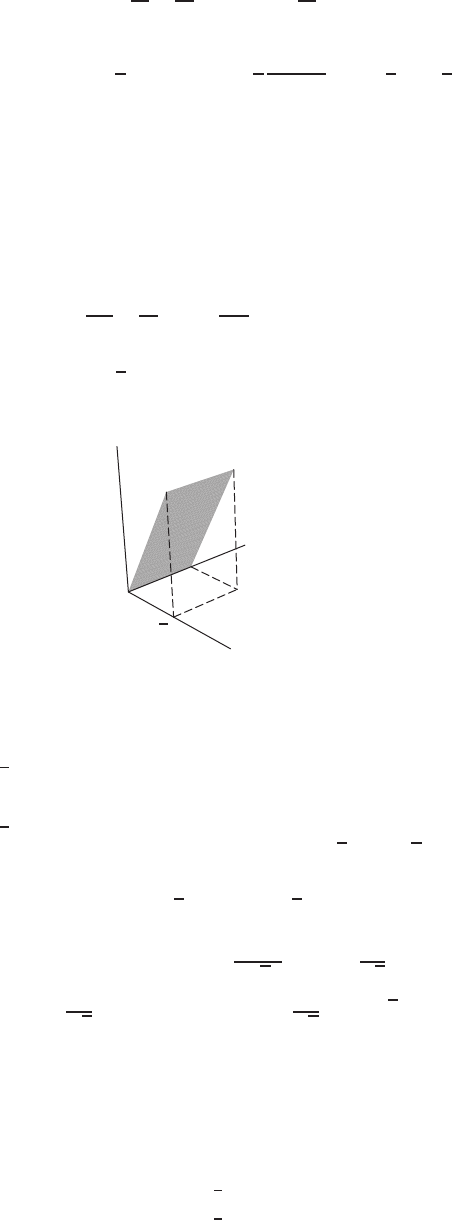
1748 Chapter Nineteen /SOLUTIONS
=Zπ/2
0 r4
2+r4
2cos θsin θ−r2
2
1
0!dθ
=Zπ/2
0
1
2cos θsin θ dθ =1
2
(sin θ)2
2
π/2
0
=1
412=1
4.
55. On the disk, z= 0 and d~
A=~
k dx dy, so
ZS
~
F·d~
A=Zx2+y2≤1
(xzeyz
~
i+x~
j+ (5 + x2+y2)~
k)·~
k dx dy
=Zx2+y2≤1
(5 + x2+y2)dx dy =Z2π
0Z1
0
(5 + r2)r dr dθ
= 2π5r2
2+r4
4
1
0
=11π
2.
56. The plane is x−z= 0 over region 0≤x≤√2,0≤y≤2. See Figure 19.10.
x
z
√2
2
2
y
Figure 19.10
Flux = Z2
0Z√2
0(exy + 3z+ 5)
~
i+ (exy + 5z+ 3)~
j+ (3z+exy)~
k·(
~
i−~
k)dx dy
=Z2
0Z√2
0
(exy + 3z+ 5 −3z−exy)dx dy = 5(2)(√2) = 10√2
Alternatively, since a unit normal to the surface is ~n /√2 = (
~
i−~
j)/√2, writing dA =||d~
A||, we have
Flux = ZS
~
H·d~
A=Z~
H·~
i−~
k
√2dA =Z5
√2dA
=5
√2(Area of slanted square) =5
√24 = 10√2.
57. (a) The charge is contained in a sphere of radius acentered at the origin, and uniformly distributed through the region
enclosed by the sphere.
(b) Since ~e ρis the unit vector outward normal to the sphere of radius ρ, we have ~
E=E(ρ)~e ρ. Let Sbe a sphere of
fixed radius ρ, centered at the origin. Then
ZW
δdV =(4
3πρ3δ0ρ≤a
4
3πa3δ0ρ > a.
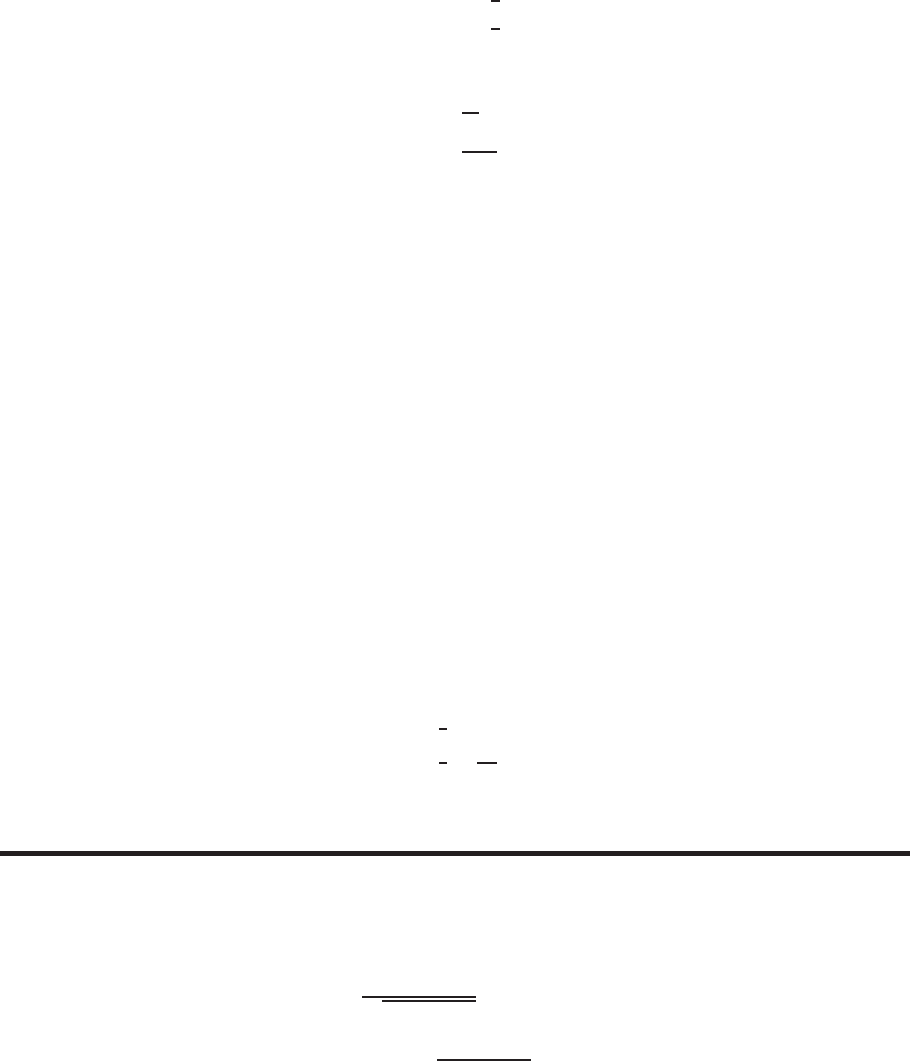
19.2 SOLUTIONS 1749
On the other hand, since on the sphere d~
A=~e ρdA, we have
ZS
~
E·d~
A=ZS
E(ρ)~
eρ·~e ρdA =E(ρ)ZS
dA =E(ρ)4πρ2.
Therefore, by Gauss’s Law,
E(ρ)4πρ2=(k4
3πρ3δ0ρ≤a
k4
3πa3δ0ρ > a.
Since ~
E=E(ρ)~e ρ, simplifying gives
~
E=
kδ0
3ρ~e ρρ≤a
kδ0a3
3r3~e ρρ > a.
58. (a) The charge is contained in a cylinder of radius acentered at the origin, and uniformly distributed through the region
enclosed by the cylinder.
(b) Since ~e ris the unit outward pointing normal to the cylinder of radius r, we have ~
E=E(r)~e r. Let Sbe a cylinder
of fixed radius r, height 1, centered along the z-axis. If r≤a,
ZW
δdV =πr2δ0,
and if r > a ZW
δ dV =πa2δ0.
On the other hand, since d~
A=~e rdA on S, we can write
ZS
~
E·d~
A=ZS
E(r)(~e r·~e r)dA =E(r)ZS
dA =E(r)2πr.
(The flux across the top and bottom of the cylinder is zero.) So, by Gauss’s Law
E(r)2πr =
kπr2δ0if r≤a
kπa2δ0if r > a.
Since ~
E=E(r)~e r, simplifying gives
~
E=
1
2kδ0r~e rif r≤a
1
2kδ0a2
r~e rif r > a.
Strengthen Your Understanding
59. The formula d~
A=cos θ
~
i+ sin θ~
jR dz dθ applies only to surfaces that lie on a cylinder centered on the z-axis of
constant radius R. The distance from the cone to the z-axis is not constant, but depends on the point on the cone from
which you measure the distance.
60. The orientation vector ~n is a unit vector in the direction of d~
A, so
~n =1
pf2
x+f2
y+ 1 −fx
~
i−fy~
j+~
k
and
dA =pf2
x+f2
y+ 1 dx dy.
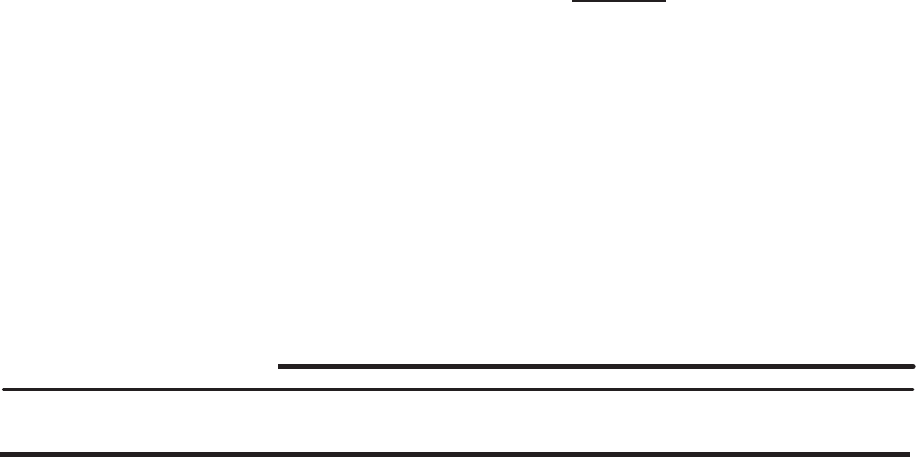
1750 Chapter Nineteen /SOLUTIONS
61. For a surface z=f(x, y)oriented upwards, we have
d~
A=−fx
~
i−fy~
j+~
kdx dy.
If f(x, y) = −x−y, then fx=−1,fy=−1, and
d~
A= (
~
i+~
j+~
k)dx dy.
62. The vector field ~
F=x
~
i+y~
jin polar coordinates is
~
F(r, θ, z) = rcos θ
~
i+rsin θ~
j .
For a surface Son the cylinder r= 10, oriented outwards, we have
ZS
~
F·d~
A=ZT
~
F(10, θ, z)·cos θ
~
i+ sin θ~
j10 dz dθ
=ZT10 cos θ
~
i+10 sin θ~
j·cos θ
~
i+ sin θ~
j10 dz dθ
=ZT
100 dz dθ = 100 ·ZT
dz dθ,
where Tis the θz-region corresponding to S. If, for example, 0≤θ≤2and 0≤z≤3, then RTdz dθ is 6. Hence
RS~
F·d~
A=600 for the surface Sparameterized by r= 10,0≤θ≤2,0≤z≤3, oriented outwards.
An intuitive geometric solution is also possible. On the cylinder x2+y2= 102of radius 10, the vector field
~
F=x
~
i+y~
jhas magnitude k~
Fk= 10 and is normal to the cylinder, pointing in the orientation direction. Hence, for a
surface Son the cylinder oriented away from the z-axis, we have
ZS
~
F·d~
A= 10 ·Area of S.
The region Son the cylinder r= 10 with 0≤θ≤2,0≤z≤3is a curved rectangle with base 10∆θ= 10 ·2 = 20
and height 3, so has area 60. Hence RS~
F·d~
A=600.
63. True. The area vector for the graph of f(x, y), parametrized in the usual way, is given by ~
A=fx
~
i+fy~
j+~
k. The
surface area is then the double integral of the magnitude of ~
A, namely pf2
x+f2
y+ 1 over the given rectangle.
64. False. Both surfaces are oriented upward, so ~
A(x, y)and ~
B(x, y)both point upward. But they could point in different
directions, since the graph of z=−f(x, y)is the graph of z=f(x, y)turned upside down.
65. False. The total flux can be 0 without the vector field always being perpendicular to the surface. For example, if F(x, y, z) =
~
k, then the flux is zero over the sphere, but Fis not perpendicular to the sphere except at the north and south poles.
66. (a) The surface can be considered as made up of two rectangles, the original one and another “next door” along the
x-axis. Because the vector field is independent of x, the flux through both rectangles are the same. Thus, the flux has
doubled.
(b) Because the vector field does not depend on x, the flux is unchanged.
(c) The sign is reversed, but the magnitude of the flux remains the same.
(d) Tripling each side of the rectangle multiplies its area by 9. However, the surface now extends further up the z-axis,
where the vector field is not given. If the vector field is larger further up the z-direction (as suggested by the diagram),
then the flux has multiplied by a factor of more than 9.
Solutions for Section 19.3
Exercises
1. Scalar. div (x2+y)
~
i+ (xyez)~
j−(ln(x2+y2))~
k= 2x+xez
2. Scalar. div((2 sin(xy) + tan z)
~
i+ (tan y)~
j+ (ex2+y2)~
k) = 2ycos(xy) + 1/cos2y.
3. The first vector field appears to be diverging more at the origin, since both fields are zero at the origin and the vectors near
the origin are larger in field (I) than they are in field (II).
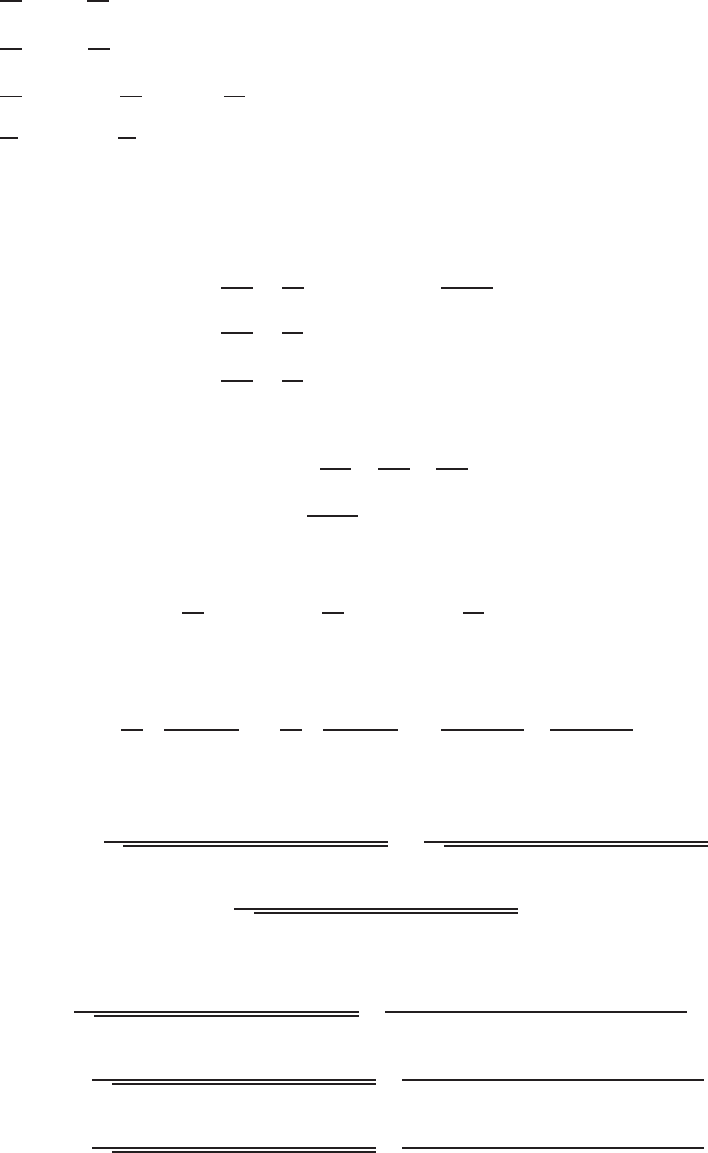
19.3 SOLUTIONS 1751
4. (a) Positive. The inflow from the lower left is less than the outflow from the upper right. The net outflow is positive.
(b) Zero. The inflow on the right side is equal to outflow on the left.
(c) Negative. The inflow from above is greater than the outflow below. The net outflow is negative.
5. div ~
F=∂
∂x (−y) + ∂
∂y (x) = 0
6. div ~
F=∂
∂x (−x) + ∂
∂y (y) = −1 + 1 = 0
7. div ~
F=∂
∂x (−x+y) + ∂
∂y (y+z) + ∂
∂z (−z+x) = −1 + 1 −1 = −1
8. div ~
F=∂
∂x (x2−y2) + ∂
∂y (2xy) = 2x+ 2x= 4x
9. We have
div(3x2
~
i−sin(xz)(
~
i+~
k)) = 6x−zcos(xz)−xcos(xz).
10. We have
∂F1
∂x =∂
∂x ln x2+ 1=2x
x2+ 1 ,
∂F2
∂y =∂
∂y (cos y) = −sin y,
∂F3
∂z =∂
∂z (xyez) = xyez.
So,
div ~
F=∂F1
∂x +∂F2
∂y +∂F3
∂z
=2x
x2+ 1 −sin y+xyez.
11. Using the formula for ~a ×~r in Cartesian coordinates, we get
div ~
F=∂
∂x (a2z−a3y) + ∂
∂y (a3x−a1z) + ∂
∂z (a1y−a2x) = 0
12. Taking partial derivatives, we get
div ~
F=∂
∂x −y
(x2+y2)+∂
∂y x
(x2+y2)=2xy
(x2+y2)2−2yx
(x2+y2)2= 0.
13. In coordinates, we have
~
F(x, y, z) = (x−x0)
p(x−x0)2+ (y−y0)2+ (z−z0)2
~
i+(y−y0)
p(x−x0)2+ (y−y0)2+ (z−z0)2
~
j
+(z−z0)
p(x−x0)2+ (y−y0)2+ (z−z0)2
~
k .
So if (x, y, z)6= (x0, y0, z0), then
div ~
F= 1
p(x−x0)2+ (y−y0)2+ (z−z0)2−(x−x0)2
((x−x0)2+ (y−y0)2+ (z−z0)2)3/2!
+ 1
p(x−x0)2+ (y−y0)2+ (z−z0)2−(y−y0)2
((x−x0)2+ (y−y0)2+ (z−z0)2)3/2!
+ 1
p(x−x0)2+ (y−y0)2+ (z−z0)2−(z−z0)2
((x−x0)2+ (y−y0)2+ (z−z0)2)3/2!
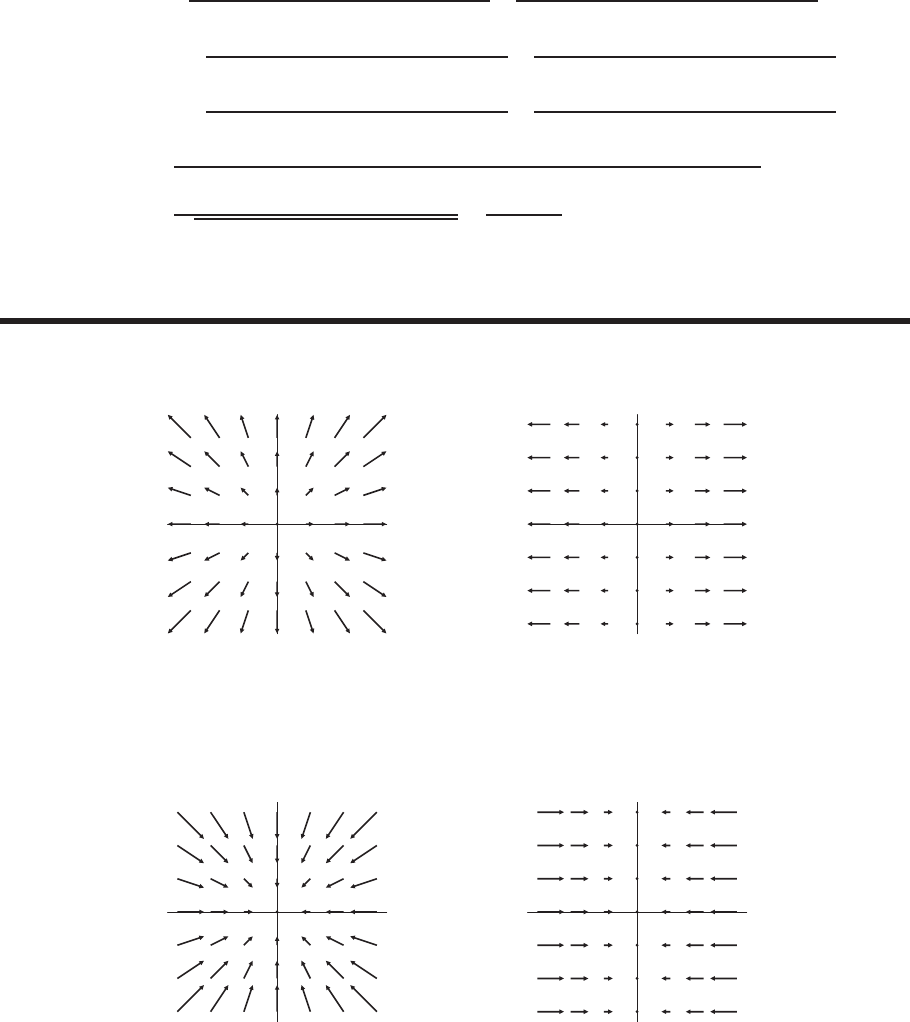
1752 Chapter Nineteen /SOLUTIONS
=(x−x0)2+ (y−y0)2+ (z−z0)2
((x−x0)2+ (y−y0)2+ (z−z0)2)3/2−(x−x0)2
((x−x0)2+ (y−y0)2+ (z−z0)2)3/2
+(x−x0)2+ (y−y0)2+ (z−z0)2
((x−x0)2+ (y−y0)2+ (z−z0)2)3/2−(y−y0)2
((x−x0)2+ (y−y0)2+ (z−z0)2)3/2
+(x−x0)2+ (y−y0)2+ (z−z0)2
((x−x0)2+ (y−y0)2+ (z−z0)2)3/2−(z−z0)2
((x−x0)2+ (y−y0)2+ (z−z0)2)3/2
=3((x−x0)2+ (y−y0)2+ (z−z0)2)−((x−x0)2+ (y−y0)2+ (z−z0)2)
((x−x0)2+ (y−y0)2+ (z−z0)2)3/2
=2
p(x−x0)2+ (y−y0)2+ (z−z0)2=2
k~r −~r 0k.
Problems
14. Two vector fields that have positive divergence everywhere are in Figures 19.11 and 19.12.
x
y
Figure 19.11
x
y
Figure 19.12
15. Two vector fields that have negative divergence everywhere are in Figures 19.13 and 19.14.
x
y
Figure 19.13
x
y
Figure 19.14
16. Two vector fields that have zero divergence everywhere are in Figures 19.15 and 19.16.
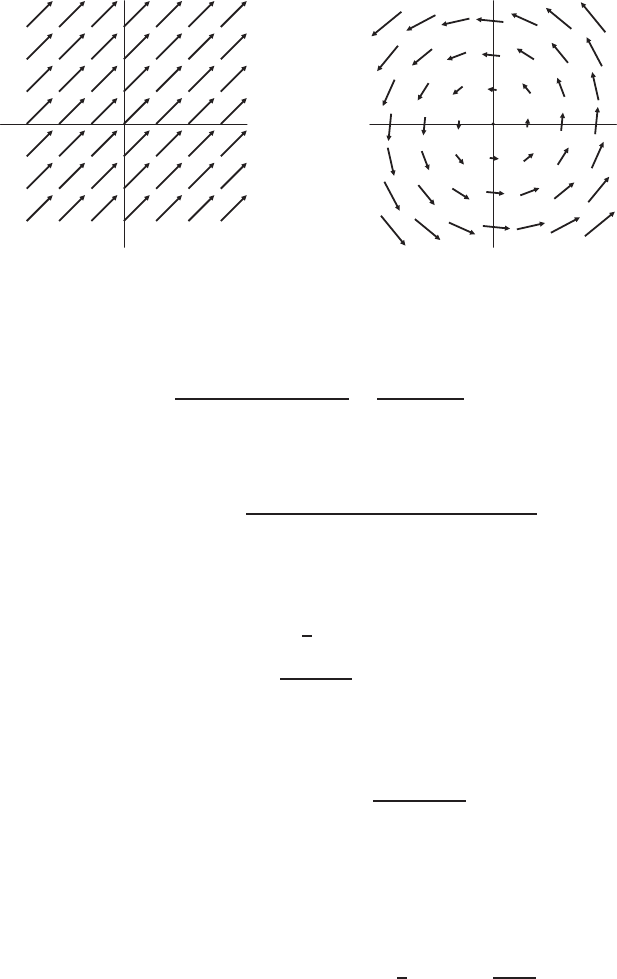
19.3 SOLUTIONS 1753
x
y
Figure 19.15
x
y
Figure 19.16
17. Since div ~
Gat a point is approximately equal to the flux density out of a small region around the point, at (2,3,−1) we
have
div ~
G≈Flux out of small region
Volume of region =−0.00004π
4π(0.1)3/3=−0.030.
Note that since the original flux was given into the region, we take the negative to get the flux out of the region.
18. Since div F(1,2,3) is the flux density out of a small region surrounding the point (1,2,3), we have
div ~
F(1,2,3) ≈Flux out of small region around (1,2,3)
Volume of region.
So
Flux out of region ≈(div ~
F(1,2,3)) ·Volume of region
= 5 ·4
3π(0.01)3
=0.00002π
3.
19. (a) (i) By the definition of divergence, if Sis a sphere centered at (2,0,0), we have
div ~
F= lim
Vol→0RS~
F·d~
A
Volume of S.
Thus, if the sphere is small ZS
~
F·d~
A≈div ~
F·Volume of S.
Since div ~
F=x2+y2−z, if Sis the sphere given
ZS
~
F·d~
A≈(22+ 02−0) ·4
3π(0.1)3=0.016
3π.
(ii) The relationship between flux, divergence, and volume holds when Sis cube. Thus
ZS
~
F·d~
A≈div ~
F·Volume of S,
gives ZS
~
F·d~
A≈(02+ 02−10) ·(0.2)3=−0.08.
(b) The point (2,0,0) is a source because the flux out of a small region around the point is positive; (0,0,10) is a sink
because the flux out of a small region around the point is negative.
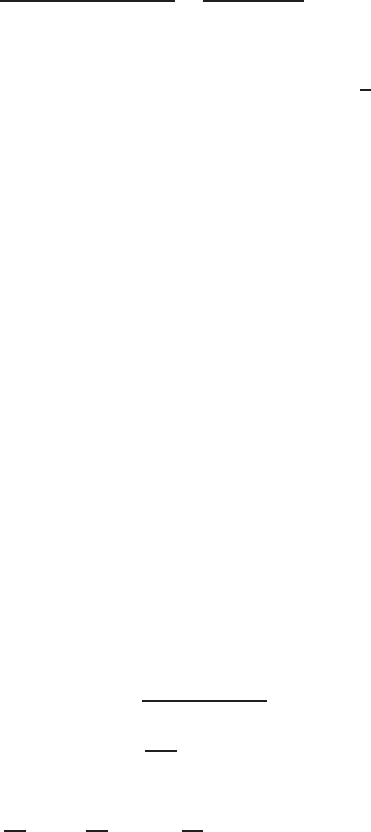
1754 Chapter Nineteen /SOLUTIONS
20. (a) Since div ~
Fat a point is approximately equal to the flux density out of a small region around the point, at (4,5,2),
we have
div ~
F≈Flux out of small region
Volume of region =0.0125
(4/3)π(0.1)3= 2.984.
(b) The flux through the sphere is approximated by
Flux through sphere =ZS
~
F·d~
A≈div ~
F·Volume of sphere = 2.984 ·4
3π(0.2)3= 0.100.
We could also estimate the flux by noticing that it is eight times the original flux, that is, 8(0.0125) = 0.100.
21. (a) On S1,x=aand normal is in negative x-direction, so
~
F·∆~
A= (2a
~
i−3y~
j+ 5z~
k)·(−∆A~
i) = −2a∆A.
Thus ZS1
~
F·d~
A=ZS1−2adA =−2a(Area of S1) = −2aw2.
On S2,x=a+wand normal is in positive x-direction, so
~
F·∆~
A= (2(a+w)
~
i−3y~
j+ 5z~
k)·(∆A~
i) = 2(a+w)∆A.
Thus ZS2
~
F·d~
A=ZS2
2(a+w)dA= 2(a+w)(Area of S2) = 2(a+w)w2
Calculating the flux through the other sides similarly, we get
Total flux
=ZS1
~
F·d~
A+ZS2
~
F·d~
A+ZS3
~
F·d~
A+ZS4
~
F·d~
A+ZS5
~
F·d~
A+ZS6
~
F·d~
A
=−2aw2+ 2(a+w)w2+ 3bw2−3(b+w)w2−5cw2+ 5(c+w)w2
= (2w−3w+ 5w)w2= 4w3.
(b) To find div ~
Fat the point (a, b, c), let the box shrink to the point by letting w→0. Then
div ~
F= lim
w→0Flux through box
Volume of box
= lim
w→04w3
w3= 4.
(c)
div ~
F=∂
∂x (2x) + ∂
∂y (−3y) + ∂
∂z (5z) = 2 −3 + 5 = 4.
22. Using flux: On S1, x =aand normal is in negative x-direction, so
~
F·∆~
A= ((3a+ 2)
~
i+ 4a~
j+ (5a+ 1)~
k)·(−∆A~
i) = −(3a+ 2)∆A
Thus ZS1
~
F·d~
A=ZS1−(3a+ 2)dA =−(3a+ 2)(Area of S1) = −(3a+ 2)w2.
On S2, x =a+wand normal is in the positive x-direction, so
~
F·∆~
A= [(3(a+w) + 2)~
i+ 4(a+w)~
j+ (5(a+w) + 1)~
k]·(∆A~
i) = (3a+ 3w+ 2)∆A.
Thus ZS2
~
F·d~
A=ZS2
(3a+3w+ 2)dA = (3a+ 3w+ 2)(Area of S2) = (3a+ 3w+ 2)w2.
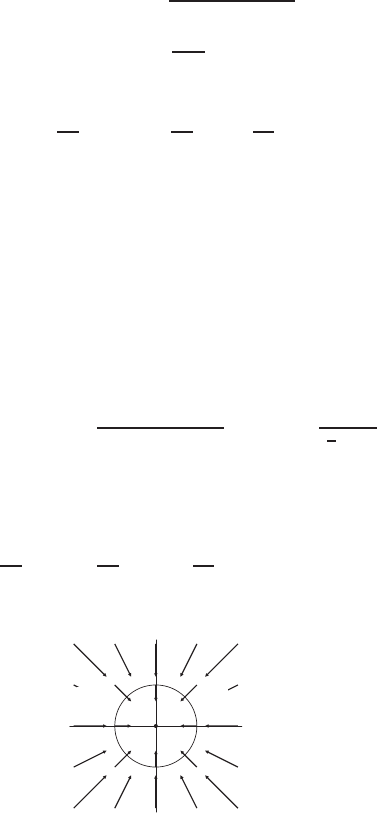
19.3 SOLUTIONS 1755
Next, we have RS3
~
F·d~
A=RS3−4xdA and RS4
~
F·d~
A=RS44xdA. Since these two are integrated over the same
region in the xz-plane, the two integrals cancel. Similarly, RS5
~
F·d~
A=RS5−(5x+ 1)d~
Acancels out RS6
~
F·d~
A=
RS6(5x+1)d~
A. Therefore,
Total flux
=ZS1
~
F·d~
A+ZS2
~
F·d~
A+ZS3
~
F·d~
A+ZS4
~
F·d~
A+ZS5
~
F·d~
A+ZS6
~
F·d~
A
=−(3a+ 2)w2+ (3a+ 3w+ 2)w2+ZS3−4xdA +ZS4
4xdA
+ZS5−(5x+ 1)dA +ZS6
(5x+ 1)dA = 3w3.
To find div ~
Fat the point (a, b, c), let the box shrink to the point by letting w→0. Then
div ~
F= lim
w→0Flux through box
Volume of box
= lim
w→03w3
w3= 3.
Using partial derivatives:
div ~
F=∂
∂x (3x+ 2) + ∂
∂y (4x) + ∂
∂z (5x+ 1) = 3
23. Figure 19.17 shows a two dimensional cross-section of the vector field ~v =−2~r . The vector field points radially inward,
so if we take Sto be a sphere of radius Rcentered at the origin, oriented outward, we have
~v ·∆~
A=−2Rk∆~
Ak,
for a small area vector ∆~
Aon the sphere. Therefore,
ZS
~
v·d~
A=ZS−2Rkd~
Ak=−2R(Surface area of sphere) = −2R(4πR2) = −8πR3.
Thus, we find that
div ~v (0,0,0) = lim
vol→0 RS~
v·d~
A
Volume of sphere != lim
R→0−8πR3
4
3πR3=−6.
Notice that the divergence is negative. This is what you would expect, since the vector field represents an inward flow at
the origin.
Since ~v =−2~r =−2x
~
i−2y~
j−2z~
k, the coordinate definition give
div ~v =∂
∂x (−2x) + ∂
∂y (−2y) + ∂
∂z (−2z) = −2−2−2 = −6.
−RR
x
y
Figure 19.17
: The vector field ~v =−2~r
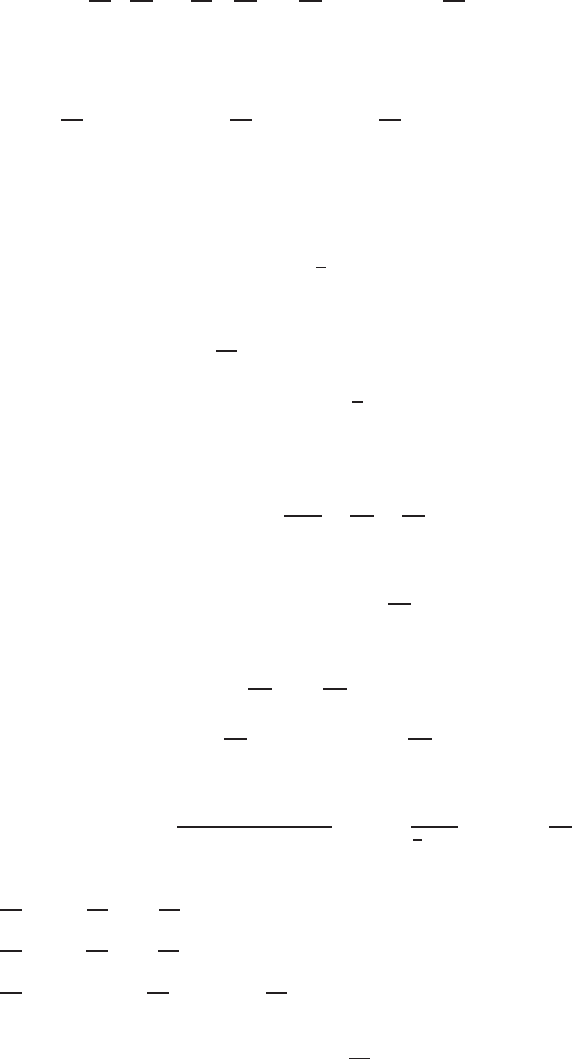
1756 Chapter Nineteen /SOLUTIONS
24. (a) Since ais a constant,
div grad f=∂
∂x ∂f
∂x +∂
∂y ∂f
∂y =∂
∂x (ay + 2axy) + ∂
∂y (ax +ax2+ 3y2) = 2ay + 6y.
(b) Since div grad f= (2a+ 6)y, we have div grad f= 0 for all x, y if a=−3.
25. (a) Since
div ~
F=∂
∂x (9a2x+ 10ay2) + ∂
∂y (10z3−6ay) + ∂
∂z (−3z−10x2−10y2) = 9a2−6a−3,
we have div ~
F= 0 when
9a2−6a−3 = 0
3(3a+ 1)(a−1) = 0
a=−1
3or a= 1.
(b) Taking the derivative with respect to ato locate the minimum gives
d
da (9a2−6a−3) = 18a−6 = 0
a=1
3.
This value of agives a minimum because the expression for div ~
Fis an upward-opening parabola.
26. Take Sto be a small sphere of radius Rcentered at the origin. Then on Swe have
k~
Fk=k~
Rk
R3=R
R3=1
R2.
In addition, since ~
Fpoints radially outward, ~
Fis parallel to the outward normal on the surface, so
~
F·∆~
A=k~
Fk∆A=1
R2∆A.
Thus,
ZS
~
F·d~
A=ZS
1
R2dA =1
R2ZS
dA
=1
R2·(Area of sphere) = 1
R2(4πR2) = 4π.
The divergence is therefore given by
div ~
F= lim
Vol→0
Flux out of sphere
Volume inside sphere = lim
R→04π
4
3πR3= lim
R→03
R3.
Since this limit is infinite, or undefined, we say that divergence of this vector field is not defined at the origin.
27. (a) div ~
B=∂
∂x (−y) + ∂
∂y (x) + ∂
∂z (x+y) = 0, so this could be a magnetic field.
(b) div ~
B=∂
∂x (−z) + ∂
∂y (y) + ∂
∂z (x) = 0 + 1 + 0 = 1, so this could not be a magnetic field.
(c) div ~
B=∂
∂x (x2−y2−x) + ∂
∂y (y−2xy) + ∂
∂z (0) = 2x−1 + 1 −2x+ 0 = 0, so this could be a magnetic field.
28. (a) We have
div ~
F=∂z
∂z = 1.
(b) Above the xy plane, the vector field consists of vectors pointing vertically upward, getting longer as you go up.
Below the xy plane, it consists of vectors pointing vertically downward, getting longer as you go down. You can
clearly see the divergence on the xy plane, since vectors on either side of it point in opposite directions, but it is not
so clear elsewhere. However, the fact that the vectors are getting longer as you go up means that the flux through a
cube situated above the xy plane will be non-zero, since the flux out of its top face will be greater than the flux into
the bottom face.
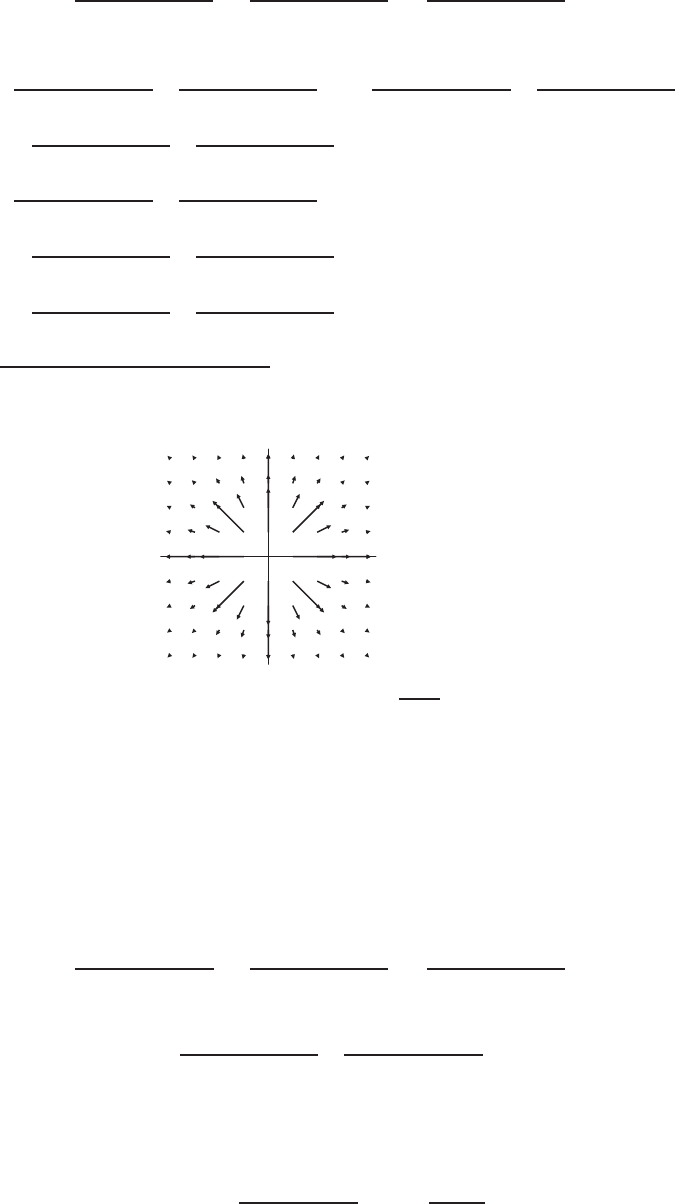
19.3 SOLUTIONS 1757
29. (a) In Cartesian coordinates,
~
F(x, y, z) = x
(x2+y2+z2)3/2~
i+y
(x2+y2+z2)3/2~
j+z
(x2+y2+z2)3/2~
k .
So if (x, y, z)6= (0,0,0), then
div ~
F(x, y, z) = 1
(x2+y2+z2)3/2−3x2
(x2+y2+z2)5/2+1
(x2+y2+z2)3/2−3y2
(x2+y2+z2)5/2
+1
(x2+y2+z2)3/2−3z2
(x2+y2+z2)5/2
=x2+y2+z2
(x2+y2+z2)5/2−3x2
(x2+y2+z2)5/2
+x2+y2+z2
(x2+y2+z2)5/2−3y2
(x2+y2+z2)5/2
+x2+y2+z2
(x2+y2+z2)5/2−3z2
(x2+y2+z2)5/2
=3(x2+y2+z2)−3(x2+y2+z2)
(x2+y2+z2)5/2
= 0.
(b)
x
z
Figure 19.18
: The vector field ~
F(~r ) = ~r
k~r k3
shown in the xz-plane
The vector field is radial (all the arrows point out), so you might think that it is has non-zero divergence. (See
Figure 19.18.) However the fact that the divergence is 0at every point shows that flux density out of any small
volume around a point must be 0. This is possible because the arrows also get shorter as you go out.
30. The charges that produce this electric field are concentrated along two vertical lines, one near x=−1and the another
one near x= 1. This is seen by the change in direction of the field at those lines. Near x=−1the field is being repulsed
by the line (seen by the field going away from the line), and the charge is therefore positive. Near x= 1 the field is being
attracted to the line (seen by the field going toward the line), and the charge is therefore negative.
31. (a) Translating the vector field into rectangular coordinates gives, if (x, y, z)6= (0,0,0)
~
E(x, y, z) = kx
(x2+y2+z2)3/2~
i+ky
(x2+y2+z2)3/2~
j+kz
(x2+y2+z2)3/2~
k .
We now take the divergence of this to get
div ~
E=k−3x2+y2+z2
(x2+y2+z2)5/2+3
(x2+y2+z2)3/2
= 0.
(b) Let Sbe the surface of a sphere centered at the origin. We have seen that for this field, the flux R~
E·d~
Ais the same
for all such spheres, regardless of their radii. So let the constant cstand for R~
E·d~
A. Then
div ~
E(0,0,0) = lim
vol→0R~
E·d~
A
Volume inside S= lim
vol→0
c
Volume .
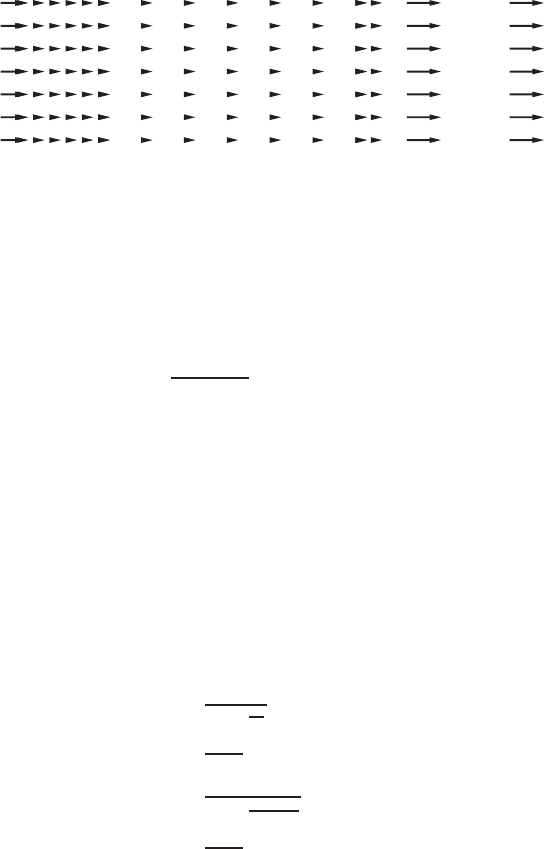
1758 Chapter Nineteen /SOLUTIONS
(c) For a point charge, the charge density is not defined. The charge density is 0everywhere else.
32. (a) The velocity vector for the traffic flow would look like:
(b) When 0≤x < 2000, the velocity is decreasing linearly from 55 to 15, so its formula is (55 −x/50)
~
imph. Then,
when 2000 ≤x < 7000, the speed is constant, so ~v (x) = 15
~
imph. Next, when 7000 ≤x < 8000, the velocity
is increasing linearly from 15 to 55, so ~v (x) = (15 + (x−7000)/25)
~
imph. Finally, when x≥8000, the speed is
constant, so ~v (x) = 55
~
imph.
(c) div ~v =dv(x)/dx.
At x= 1000,v(x) = 55 −x/50, so div ~v =−1/50.
At x= 5000,v(x) = 15, so div ~v = 0.
At x= 7500,v(x) = 15 + (x−7000)/25, so div ~v = 1/25.
At x= 10,000,v(x) = 55, so div ~v = 0.
In each case the units of div ~v are miles/hour
feet .
33. (a) Usually, the distance between cars is more at higher speeds and less at lower speeds. The cars are traveling the fastest
at x= 0, so at that point, the traffic should be the least dense. Thus,
ρ(0) < ρ(1000) < ρ(5000)
(b) Since ρis in cars/mile, ~v is in miles/hour~v is in km/hour ρ~v is in cars/hour. The vector quantity ρ~v gives the number
of cars passing through a fixed point in a time interval.
(c) Pick any two points on the highway, x=aand x=b(a < b). We expect ρ~v to be the same at both places. This
is because if more cars pass through athan b, that would mean cars are disappearing (or at least stopping, which we
know is not the case since the velocity field is not 0) between aand b. On the other hand, if more cars pass through b
than a, that would mean cars are being created between aand b. So we expect ρ~v to be the same at aand b. Since a
and bwere chosen arbitrarily, we can say that ρ~v is constant at all x. This means div(ρ~v ) = 0.
(d) At x= 0,~v (0) = 55
~
iand ρ(0) = 75. We have ρ~v (0) = 4125
~
i=constant. So ρ(x) = kρ~v k/k~v (x)k= 4125/v.
ρ(x) = 4125
55 −x
50
if 0≤x < 2000
ρ(x) = 4125
15 = 275 if 2000 ≤x < 7000
ρ(x) = 4125
15 + x−7000
25
if 7000 ≤x < 8000
ρ(x) = 4125
55 = 75 if x≥8000
(e) We have ρ(0) = 75,ρ(1000) = 118,ρ(5000) = 275, where ρis given in cars/mile. At x= 0, there are 75 cars in
a 1-mile stretch of highway. Since there are two lanes, there are about 38 cars in a mile in one lane. A mile is 5280
feet, so that says on average, one car occupies 139 feet. So at x= 0, the distance between two cars is 139 feet.
Similarly, we find that at x= 1000, the distance is 89 feet, and at x= 5000, the distance is 38 feet.
34. (a) We calculate
~r ×~c =
~
i~
j~
k
xy z
c1c2c3
= (c3y−c2z)
~
i−(c3x−c1z)~
j+ (c2x−c1y)~
k .
Thus
div(~r ×~c ) = 0.
(b) By the Divergence Theorem ZS
(~
r×~c )·d~
A= 0.
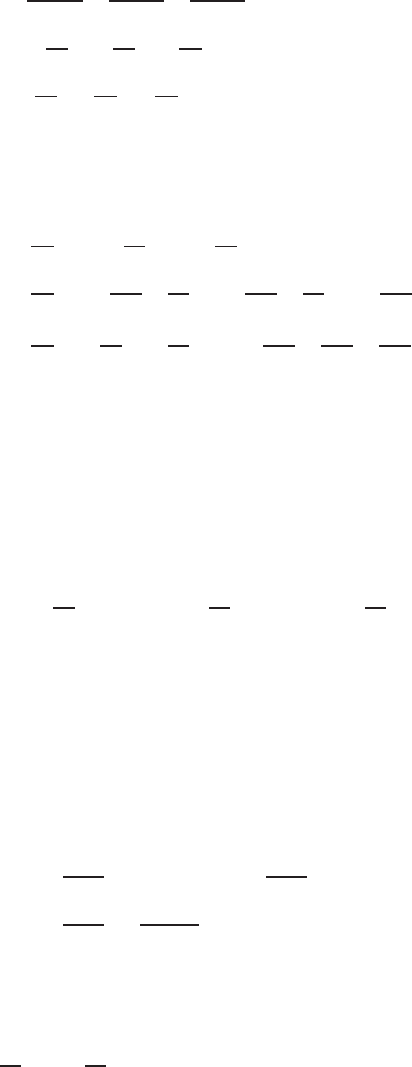
19.3 SOLUTIONS 1759
35. Let ~a =a1
~
i+a2~
j+a3~
kwith a1,a2, and a3constant. Then f~a =f(x, y, z)(a1
~
i+a2~
j+a3~
k) = f(x, y, z)a1
~
i+
f(x, y, z)a2~
j+f(x, y, z)a3~
k=fa1
~
i+fa2~
j+fa3~
k. So
div(f~a ) = ∂(f a1)
∂x +∂(fa2)
∂y +∂(fa3)
∂z
=a1
∂f
∂x +a2
∂f
∂y +a3
∂f
∂z since a1, a2, a3are constants
= ( ∂f
∂x~
i+∂f
∂y~
j+∂f
∂z ~
k)·(a1
~
i+a2~
j+a3~
k)
= (grad f)·~a .
36. Let ~
F=F1
~
i+F2~
j+F3~
k. Then
div(g~
F) = div(gF1
~
i+gF2~
j+gF3~
k)
=∂
∂x (gF1) + ∂
∂y (gF2) + ∂
∂z (gF3)
=∂g
∂x F1+g∂F1
∂x +∂g
∂y F2+g∂F2
∂y +∂g
∂z F3+g∂F3
∂z
=∂g
∂x F1+∂g
∂y F2+∂g
∂z F3+g∂F1
∂x +∂F2
∂y +∂F3
∂z
= (grad g)·~
F+gdiv ~
F .
37. Now grad f=fx
~
i+fy~
j+fz~
kand grad gis similar. Thus
grad f×grad g=
~
i~
j~
k
fxfyfz
gxgygz
= (fygz−fzgy)
~
i−(fxgz−fzgx)~
j+(fxgy−fygx)~
k .
Therefore
div(grad f×grad g) = ∂
∂x (fygz−fzgy) + ∂
∂y (fzgx−fxgz) + ∂
∂z (fxgy−fygx).
Expanding using the product rule gives
div(grad f×grad g) = fyxgz+fygzx −fzxgy−fzgyx +fzy gx+fzgxy
−fxygz−fxgzy +fxz gy+fxgyz −fyz gx−fygxz .
Now consider pairs of terms such as fyxgz−fxygz. Since fyx =fxy provided the second derivatives are continuous,
these two terms cancel out. All the other terms cancel in pairs, showing that
div(grad f×grad g) = 0.
38. Using div(g~
F) = (grad g)·~
F+gdiv ~
F, we have
div ~
F=1
k~r kpdiv(~a ×~r ) + grad( 1
k~r kp)·~a ×~r
=1
k~r kp0 + −p
k~r kp+2 ~r ·(~a ×~r )
= 0 since ~r and ~a ×~r are perpendicular.
39. Using div(g~
F) = (grad g)·~
F+gdiv ~
F, we have
div ~
B= grad 1
xa·~
r+1
xadiv ~r =−ax−(a+1)
~
i·~r +x−a(3) = (3 −a)x−a.
40. Using div(g~
F) = (grad g)·~
F+gdiv ~
F, we have
div ~
G= grad(~
b·~r )·(~a ×~r ) + ~
b·~r div(~a ×~r ) = ~
b·(~a ×~r ) + ~v ·~r 0 = ~
b·(~a ×~r ).
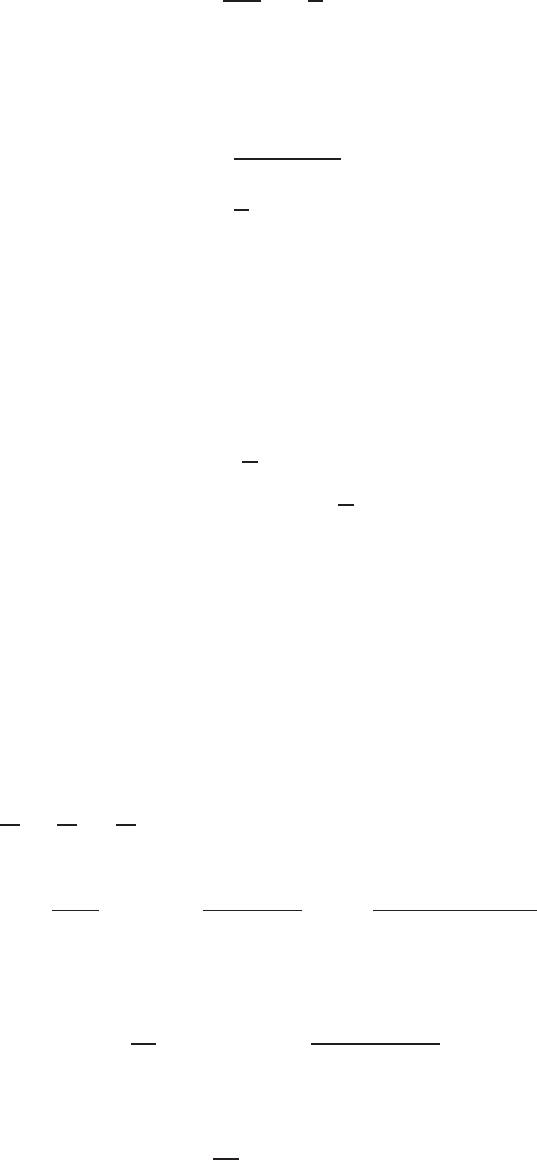
1760 Chapter Nineteen /SOLUTIONS
41. First compute the unit vectors ~
Tand ~
N. Since ~
Tis in the direction of ~
Fwe have
~
T=1
k~
Fk
~
F=1
F(u
~
i+v~
j).
Since ~
Nis the unit vector in the direction of ~
k×~
Fwe have
~
k×~
F=~
k×(u
~
i+v~
j)
=−v~
i+u~
j
~
N=1
k − v~
i+u~
jk(−v~
i+u~
j)
=1
F(−v~
i+u~
j).
The chain rule for partial differentiation of the formulas u=Fcos θand v=Fsin θgives
ux= (cos θ)Fx−F(sin θ)θx
vy= (sin θ)Fy+F(cos θ)θy.
We have
div ~
F=ux+vy
= ((cos θ)Fx−F(sin θ)θx) + ((sin θ)Fy+F(cos θ)θy)
= (−vθx+uθy) + 1
F(uFx+vFy)
= (θx
~
i+θy~
j)·(−v~
i+u~
j) + 1
F(Fx
~
i+Fy~
j)·(u
~
i+v~
j)
=Fgrad θ·~
N+ grad F·~
T .
Since the directional derivative of θin the direction of ~
Nis θ~
N= grad θ·~
Nand the directional derivative of Fin
the direction of ~
Tis F~
T= grad F·~
Twe have
div ~
F=F θ ~
N+F~
T.
42. We have now our temperature a function depending on t, x, y, z, hence T=T(t, x, y, z). For a fixed moment, say t0, T
is a function of only x, y, z. For this moment, t=t0, we have:
Rate of heat loss
from volume V=kZS
(grad T)·d~
A .
where grad T=∂T
∂x~
i+∂T
∂y ~
j+∂T
∂z ~
kt=t0
. Now the rate of change, with respect to time, in the average temperature
in the region, at t=t0, is proportional to the average rate at which heat is being lost per unit volume at t=t0, so
∂Tavg
∂t t=t0
=−cRate heat lost
Volume Vt=t0
=−ck RS(grad T)·d~
A
Volume V
Taking the limit as Vshrinks around the point, the average temperature through the region becomes the temperature at
that point. Thus using the definition of the divergence (with respect to x, y, z), we have
∂T
∂t t=t0
=−ck lim
V→0 RS(grad T)·d~
A
Volume V!
= (−ck div grad T)t=t0
As this holds at every moment t0,one has:
∂T
∂t =B·div grad T,
where B=−ck is a function of time only, and the gradient and divergence are taken with respect to the variables x, y, z.
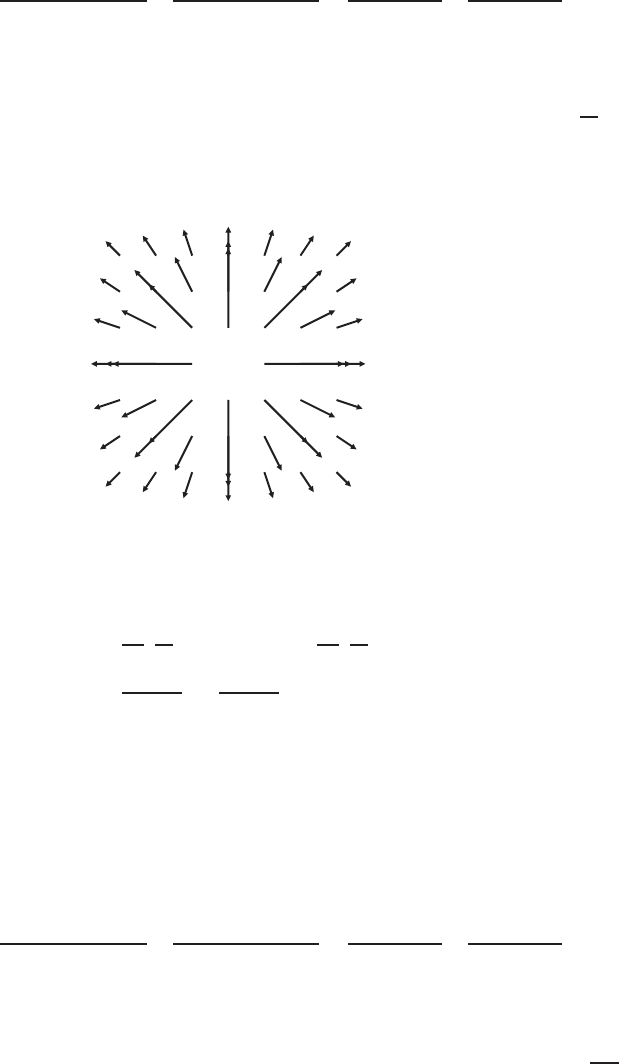
19.3 SOLUTIONS 1761
43. (a) At any point ~r =x
~
i+y~
j, the direction of the vector field ~v is pointing away from the origin, which means it is of
the form ~v =f~r for some positive function f, whose value can vary depending on ~r . The magnitude of ~v depends
only on the distance r, thus fmust be a function depending only on r, which is equivalent to depending only on r2
since r≥0. So ~v =f(r2)~r =f(x2+y2)(x
~
i+y~
j).
(b) At (x, y)6= (0,0) the divergence of ~v is
div ~v =∂(K(x2+y2)−1x)
∂x +∂(K(x2+y2)−1y)
∂y =Ky2−Kx2
(x2+y2)2+Kx2−Ky2
(x2+y2)2= 0.
Therefore, ~v is a point source at the origin.
(c) The magnitude of ~v is
k~v k=K(x2+y2)−1|x
~
i+y~
j|=K(x2+y2)−1(x2+y2)1/2=K(x2+y2)−1/2=K
r.
(d) The vector field looks like that in Figure 19.19:
x
y
Figure 19.19
(e) We need to show that grad φ=~v .
grad φ=∂
∂x (K
2log(x2+y2))
~
i+∂
∂y (K
2log(x2+y2))~
j
=Kx
x2+y2~
i+Ky
x2+y2~
j
=K(x2+y2)−1(x
~
i+y~
j)
=~v
44. (a) At any point ~r =x
~
i+y~
j, the direction of the vector field ~v is pointing toward the origin, which means it is of
the form ~v =f~r for some negative function fwhose value can vary depending on ~r . The magnitude of ~v depends
only on the distance r, thus fmust be a function depending only on r, which is equivalent to depending only on r2
since r≥0. So ~v =f(r2)~r =f(x2+y2)(x
~
i+y~
j).
(b) At (x, y)6= (0,0) the divergence of ~v is
div ~v =∂(K(x2+y2)−1x)
∂x +∂(K(x2+y2)−1y)
∂y =Ky2−Kx2
(x2+y2)2+Kx2−Ky2
(x2+y2)2= 0.
Therefore, ~v is a point sink at the origin.
(c) The magnitude of ~v is
k~v k=|K|(x2+y2)−1|x
~
i+y~
j|=|K|(x2+y2)−1(x2+y2)1/2=|K|(x2+y2)−1/2=|K|
r.
(remember, K < 0)
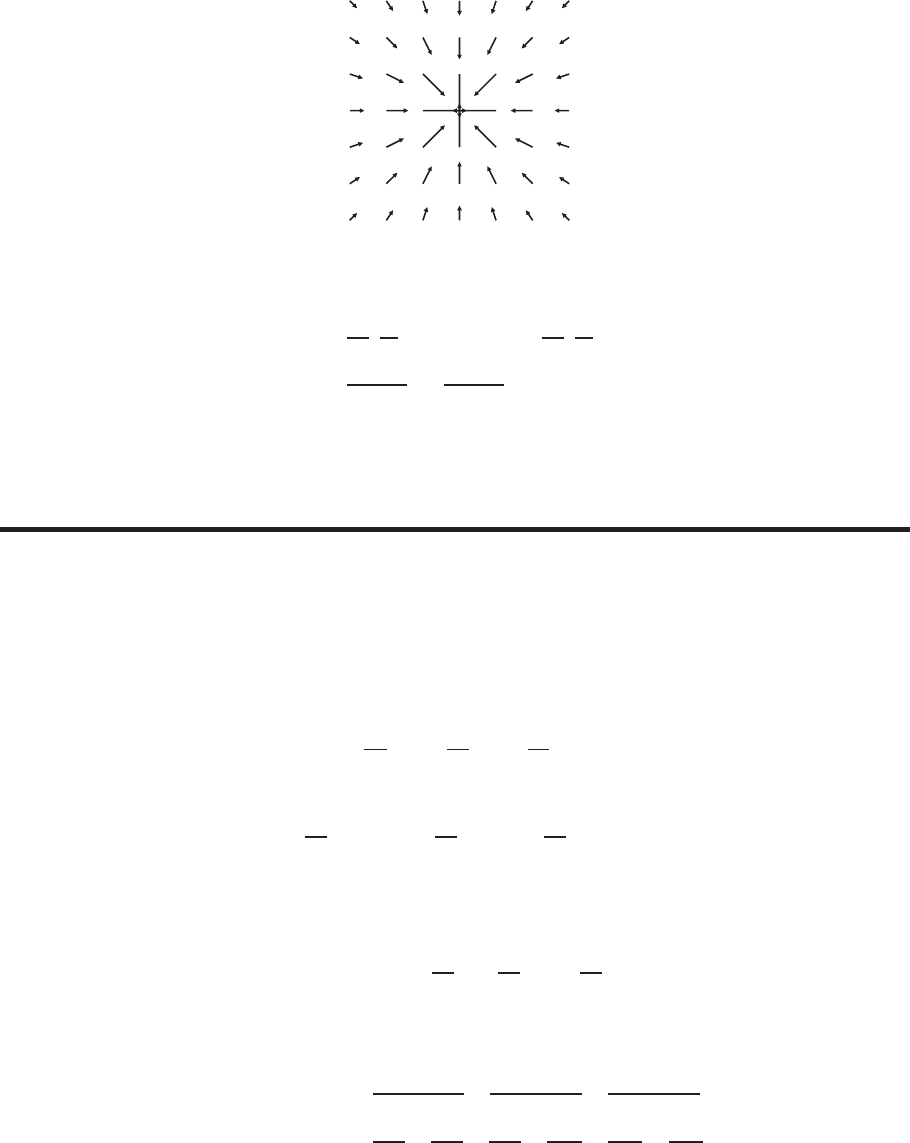
1762 Chapter Nineteen /SOLUTIONS
(d) The vector field looks like the following:
Figure 19.20
(e) We need to show that grad φ=~v .
grad φ=∂
∂x (K
2log(x2+y2))
~
i+∂
∂y (K
2log(x2+y2))~
j
=Kx
x2+y2~
i+Ky
x2+y2~
j
=K(x2+y2)−1(x
~
i+y~
j)
=~v
Strengthen Your Understanding
45. Divergence of a vector field is a scalar not a vector. We have div(2x
~
i) = 2.
46. The divergence of a vector field is a scalar function, not a vector field. The correct divergence is
div ~
F= 2x+ 2 −2z.
47. Only vector fields have a divergence. A scalar function such as f(x, y, z) = x2+yz does not have a divergence.
48. If ~
F(x, y, z) = 2x
~
i+ 3y~
j+ 4z~
k . then
div ~
F(x, y, z) = ∂
∂x (2x) + ∂
∂y (3y) + ∂
∂z (4z) = 2 + 3 + 4 = 9.
More complicated examples work too, such as if ~
F(x, y, z) = (2x+x2)
~
i−2xy~
j, giving
div ~
F(x, y, z) = ∂
∂x 2x+x2+∂
∂y (−2xy) + ∂
∂z 0 = (2 + 2x)−2x+ 0 = 2.
49. If
~
F(x, y, z) = y2
~
i+xz~
j+x~
k
then
div ~
F(x, y, z) = ∂
∂x y2+∂
∂y (xz) + ∂
∂z x= 0.
50. The vector field ~
F(x, y) = 2x
~
iis not divergence free since div ~
F(x, y) = 2 6= 0.
51. True.
div( ~
F+~
G) = ∂(F1+G1)
∂x +∂(F2+G2)
∂y +∂(F3+G3)
∂z
=∂F1
∂x +∂F2
∂y +∂F3
∂z +∂G1
∂x +∂G2
∂y +∂G3
∂z
= div ~
F+ div ~
G .
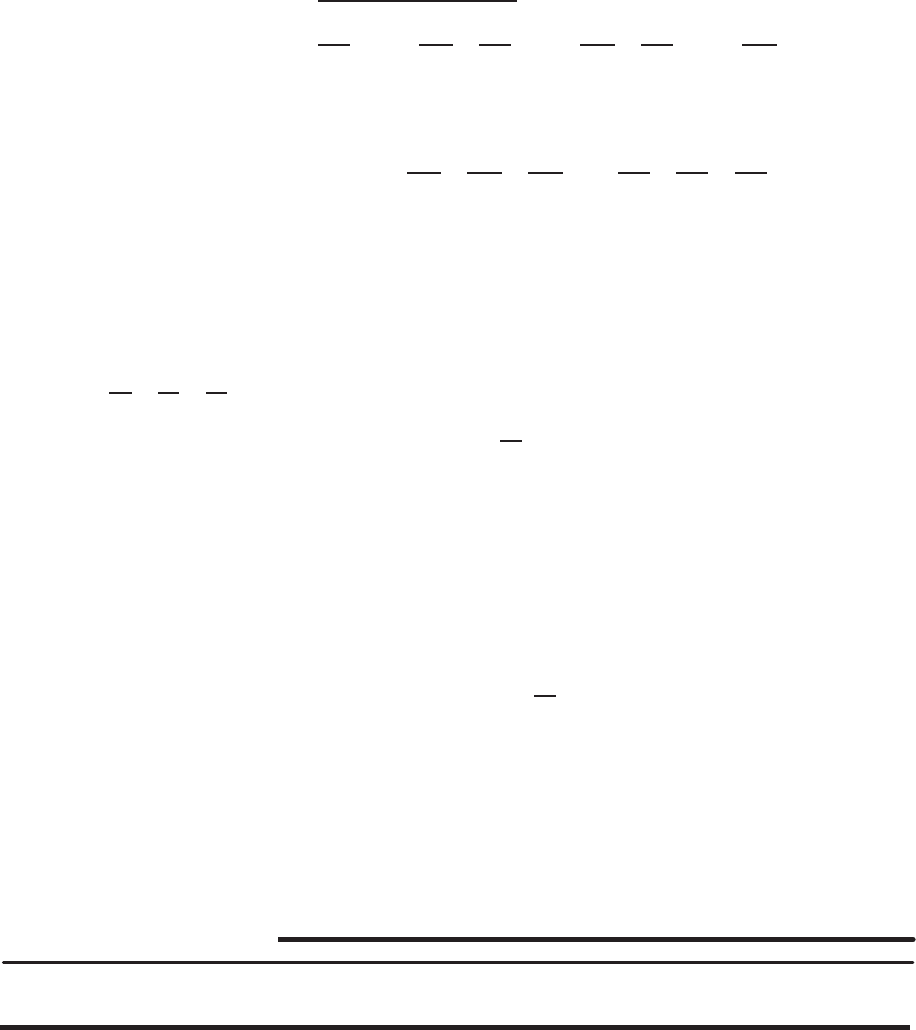
19.4 SOLUTIONS 1763
52. False. Let’s compare the x–components of each side of the equation. The x–component of grad( ~
F·~
G)is given by
(grad( ~
F·~
G))1=∂(F1G1+F2G2+F3G3)
∂x
=∂F1
∂x G1+F1∂G1
∂x +∂F2
∂x G2+F2∂G2
∂x +∂F3
∂x G3+F3∂G3
∂x .
However, the x–component of ~
F·(div ~
G) + (div ~
F)·~
Gis
(~
F(div ~
G) + (div ~
F)~
G)1=F1(div ~
G) + (div ~
F)G1
=F1∂G1
∂x +∂G2
∂y +∂G3
∂z +∂F1
∂x +∂F2
∂y +∂F3
∂z G1.
These two x–components are different and therefore
grad( ~
F·~
G)6=~
F(div ~
G) + (div ~
F)~
G .
53. True. div ~
Fis a scalar whose value depends on the point at which it is calculated.
54. False. The divergence is a scalar function that gives flux density at a point.
55. True. The net flow through a small volume is zero since the flow in is canceled by the equal flow out. Alternatively,
div ~
F=∂a
∂x +∂b
∂y +∂c
∂z = 0.
56. False. As a counterexample, consider ~
F=x~
k . Then div ~
F=∂x
∂z = 0.
57. False. As a counterexample, consider ~
F=~
iand f(x, y, z) = x. Then div(f~
F) = div x
~
i= 1, and fdiv ~
F=x·0 = 0.
58. False. As a counterexample, consider ~
F= 2x
~
i+2y~
j+2z~
k . Then ~
F= grad(x2+y2+z2),and div ~
F= 2+2+2 6= 0.
59. False. As a counterexample, consider ~
F=x2
~
iThen div ~
F= 2x, and grad 2x= 2
~
i6=~
0.
60. False. Since ~
Fcan be written ~
F(x, y, z) = x
~
i+y~
j+z~
k, the divergence of ~
Fis 3.
61. True. Here is a way of constructing a vector field ~
F. The idea is to think of fas a function of x(with yand zconstant)
and take the antiderivative. We define
g(x, y, z) = Zx
0
f(t, y, z)dt.
By the Fundamental Theorem of one-variable calculus, we know ∂g
∂x =f. So, if fis given, the vector field ~
F=
g(x, y, z)
~
ihas div ~
F=f.
62. False. As a counterexample, note that ~
F=~
iand ~
G=~
jboth have divergence zero, but are not the same vector fields.
63. False. The left-hand side of the equation, div(grad f),is a scalar function and the right hand side, grad(div ~
F), is a
vector. There cannot be an equality between a‘ scalar and a vector.
64. (a), (b), and (e) all depend on the point (x, y, z), so they are vector fields. Since div ~r = 3 and div~
i= 0, the vectors in
(c) and (d) are constant vector fields.
Solutions for Section 19.4
Exercises
1. First directly: On the faces x= 0, y = 0, z = 0,the flux is zero. On the face x= 2, a unit normal is~
iand d~
A=dA
~
i .
So ZSx=2
~r ·d~
A=ZSx=2
(2
~
i+y~
j+z~
k)·(dA
~
i)
(since on that face, x= 2)
=ZSx=2
2dA = 2 ·(Area of face) = 2 ·4 = 8.
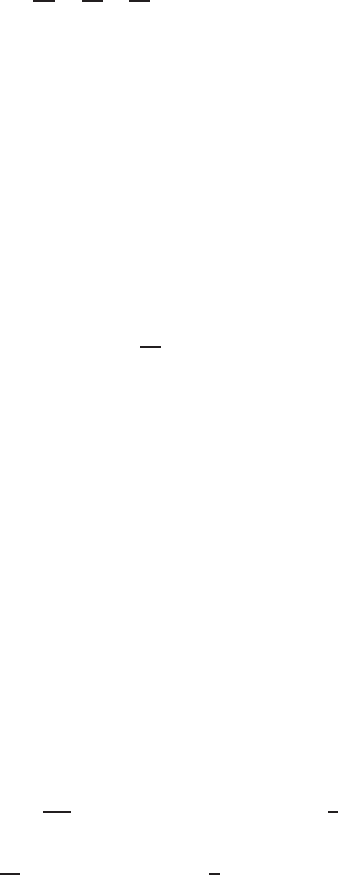
1764 Chapter Nineteen /SOLUTIONS
In exactly the same way, you get ZSy=2
~r ·d~
A=ZSz=2
~r ·d~
A= 8,
so ZS
~
r·−→
dA= 3 ·8 = 24.
Now using divergence:
div ~
F=∂x
∂x +∂y
∂y +∂z
∂z = 3,
so
Flux = Z2
0Z2
0Z2
0
3dx dy dz = 3 ·(Volume of Cube) = 3 ·8 = 24
2. First directly, since the vector field is totally in the ~
jdirection, there is no flux through the ends. On the side of the
cylinder, a normal vector at (x, y, z)is x
~
i+y~
j . This is in fact a unit normal, since x2+y2= 1 (the cylinder has radius
1). Also, using x= cos θ, y = sin θ, in this case, the element of area dA equals 1dθdz. So
Flux = Z~
F·d~
A=Z2
0Z2π
0
(y~
j)·(x
~
i+y~
j)dθ dz
=Z2
0Z2π
0
y2dθ dz =Z2
0Z2π
0
sin2θ dθ dz =Z2
0
πdz = 2π.
Now we calculate the flux using the divergence theorem. The divergence of the field is given by the sum of the
respective partials of the components, so the divergence is simply ∂y
∂y = 1. Since the divergence is constant, we can
simply calculate the volume of the cylinder and multiply by the divergence
Flux = 1πr2h= 2π
3. Finding flux directly:
1) On bottom face, z= 0 so ~
F=x2
~
i+ 2y2~
jis parallel to face so flux is zero.
2) On front face, y= 0 so ~
F=x2
~
i+ 3z2~
kis parallel to face so flux is zero.
3) On back face, y= 1 so ~
F=x2
~
i+ 2~
j+ 3z2~
kand ~
A=~
jso flux is 2.
4) On top face, z= 1 so ~
F=x2
~
i+ 2y2~
j+ 3~
kand ~
A=~
kso flux is 3.
5) On side x= 1,~
F=~
i+ 2y2~
j+ 3z2~
kand ~
A=−~
iso flux is −1.
6) On side x= 2,~
F= 4
~
i+ 2y2~
j+ 3z2~
kand ~
A=~
iso flux is 4.
Total flux is thus 8.
By the Divergence Theorem:
div ~
F= 2x+ 4y+ 6z
So, if Wis the interior of the box, we have
ZS
~
F·d~
A=ZW
(2x+ 4y+ 6z)dV = 2 Z2
1Z1
0Z1
0
(x+ 2y+ 3z)dz dy dx
= 2 Z2
1Z1
0xz + 2yz +3z2
21
0
dy dx = 2 Z2
1Z1
0 x+ 2y+3
2!dy dx
= 2 Z2
1hxy +y2+3y
2i1
0
dx = 2 Z2
1x+ 1 + 3
2dx
=Z2
1
(2x+ 5)dx = (x2+ 5x)
2
1
= 8
4. Since div ~
F= 1 + 1 + 1 = 3, the Divergence Theorem gives
ZS
~
F·d~
A=ZW
3dV= 3 ZW
dV = 3 ·Volume of the cylinder = 3π.
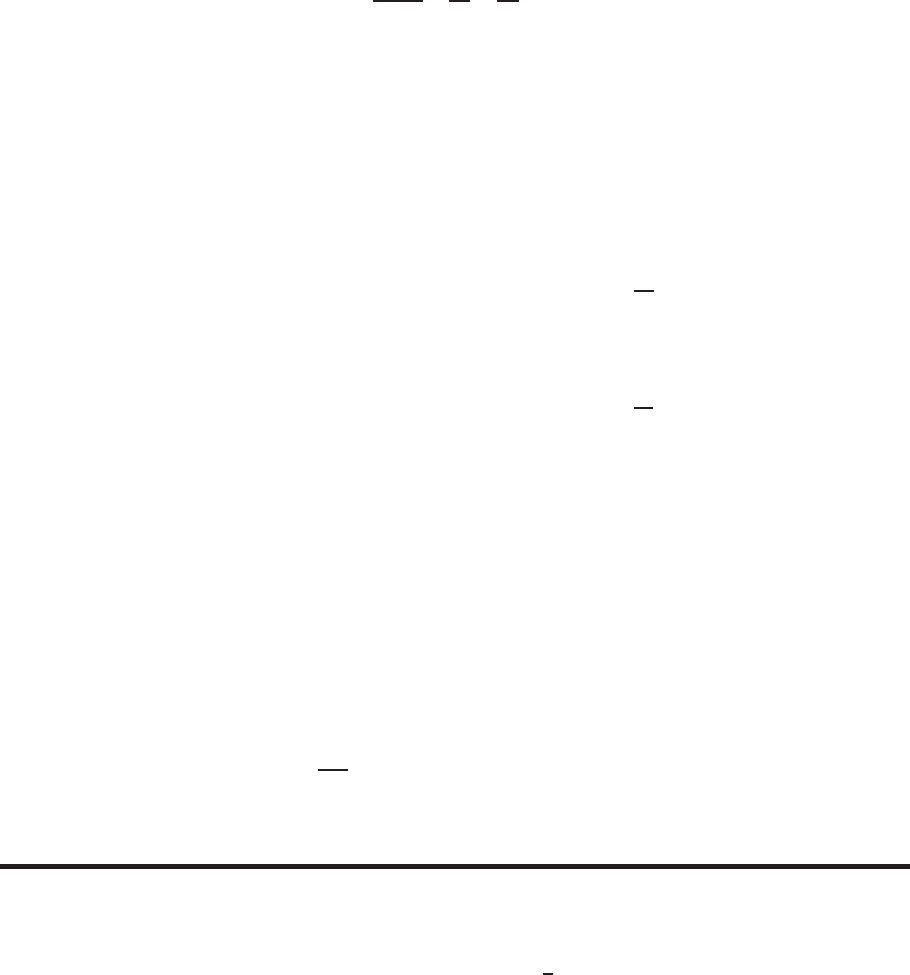
19.4 SOLUTIONS 1765
5. The location of the pyramid has not been completely specified. For instance, where is it centered on the xy plane? How
is base oriented with respect to the axes? Thus, we cannot compute the flux by direct integration with the information we
have. However, we can calculate it using the divergence theorem. First we calculate the divergence of ~
F.
div ~
F=∂(−z)
∂x +∂0
∂y +∂x
∂z = 0 + 0 + 0 = 0
Thus for any closed surface the flux will be zero, so the flux through our pyramid, regardless of its location or orientation,
is zero.
6. Since the surface is closed, the flux of a constant vector field out of it is 0.
7. Since div ~
G= 1, if Wis the interior of the box, the Divergence Theorem gives
Flux =ZW
1dV= 1 ·Volume of box = 1 ·2·3·4 = 24.
8. Since div ~
H=y, if Wis the interior of the box, the Divergence Theorem gives
Flux =ZW
ydV =Z4
0Z3
0Z2
0
y dx dy dz = 4 ·2·y2
2
3
0
= 36.
9. Since div ~
J= 2xy, if Wis the interior of the box, the Divergence Theorem gives
Flux =ZW
2xy dV =Z4
0Z3
0Z2
0
2xy dx dy dz =x2
2
0
y2
2
3
0
z
4
0
= 72.
10. Since div ~
N= 0, the flux through the closed surface of the box is 0.
11. We have
div((3x+ 4y)
~
i+ (4y+ 5z)~
j+ (5z+ 3x)~
k) = 3 + 4 + 5 = 12.
Let Wbe the interior of the cube. Then by the divergence theorem,
ZS
((3x+ 4y)
~
i+ (4y+ 5z)~
j+ (5z+ 3x)~
k)·d~
A=ZW
12 dV = 12 ·Volume of cube = 12 ·(2 ·3·4) = 288.
12. By the Divergence Theorem,
Flux =ZS
~
M·d~
A=ZW
div ~
M dV =ZW
(xy + 5) dV =Z4
0Z3
0Z2
0
(xy + 5) dx dy dz
=Z4
0Z3
0
x2y
2+ 5x
2
0
dy dz =Z4
0Z3
0
(2y+ 10) dy dz =Z4
0
(y2+ 10y)
3
0
dz = 156.
Problems
13. Since
div ~
F= 0 + 1 + 0 = 1,
we have ZS
~
F·d~
A=(div ~
F)·Vol =4
3π33= 36π.
14. Since div ~
F=y+z+x, the flux is given by
ZSphere
~
F·d~
A=ZSphere
(x+y+z)dV.
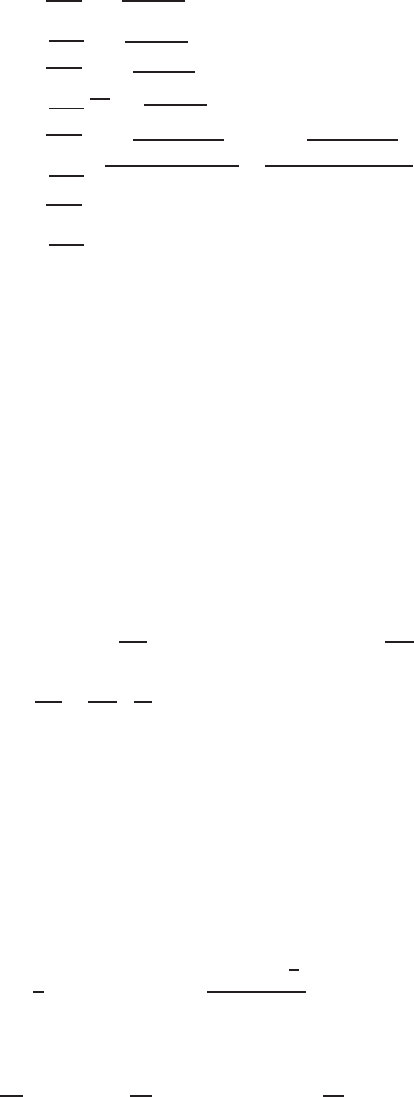
1766 Chapter Nineteen /SOLUTIONS
We calculate the first term of the integral
ZSphere
xdV =Z1
−1Z√1−z2
−√1−z2Z√1−y2−z2
−√1−y2−z2
x dx dy dz
=Z1
−1Z√1−z2
−√1−z2
x2
2
√1−y2−z2
−√1−y2−z2dy dz
=Z1
−1Z√1−z2
−√1−z2 (p1−y2−z2)2
2−(−p1−y2−z2)2
2!dy dz
=Z1
−1Z√1−z2
−√1−z2
0dydz = 0.
The other terms in the integral are zero by a similar calculation.
The same result can be obtained by a symmetry argument, which is much shorter: Since x,y, and zeach take equal
positive and negative values on half the sphere, the integral of each term is 0. Thus, the flux is zero:
ZSphere
~
F·d~
A=ZSphere
(x+y+z)dV= 0.
15. Since div ~
F= 3x2+ 3y2+ 3z2, the Divergence Theorem gives
ZS
~
F·d~
A=ZW
div ~
F dV =ZW
3(x2+y2+z2)dV.
Since Wis the interior of a cylinder of radius 2 centered on the z-axis, we use cylindrical coordinates, giving
ZS
~
F·d~
A=ZW
3(x2+y2+z2)dV = 3 Z2π
0Z2
0Z5
0
(r2+z2)rdz dr dθ
= 3 Z2π
0Z2
0r3z+rz3
3
5
0
dr dθ = 3 Z2π
0Z2
0
(5r3+125
3r)dr dθ
= 3 ·2π5r4
4+125
3·r2
2
2
0
=620π.
16. Since div ~
F= 3x2+ 3y2+ 3z2, the Divergence Theorem gives
Flux =ZS
~
F·d~
A=ZW
(3x2+ 3y2+ 3z2)dV.
In spherical coordinates, the region Wlies between the spheres ρ= 2 and ρ= 3 and inside the cone φ=π/4. Since
3x2+ 3y2+ 3z2= 3ρ2, we have
Flux =ZS
~
F·d~
A=Z2π
0Zπ/4
0Z3
2
3ρ2·ρ2sin φ dρ dφ dθ
= 2π·3
5ρ5
3
2
(−cos φ)
π/4
0
=633(2 −√2)
5π= 232.98.
17. We calculate div ~
Fand use the Divergence Theorem:
div ~
F=∂
∂x (x+ 3eyz ) + ∂
∂y (ln(x2z2+ 1) + y) + ∂
∂z (z) = 3.
Thus, with Srepresenting the surface of the cylinder and Wthe region inside, we have
ZS
~
F·d~
A=ZW
3dV= 3 ·Volume of cylinder = 3 ·π224 = 48π.
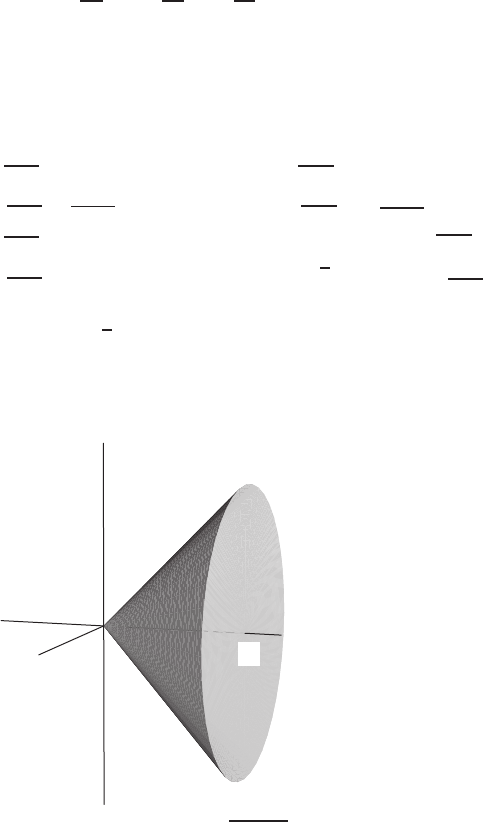
19.4 SOLUTIONS 1767
18. Since div ~
F= div(ey2z2~
i+(tan(0.001x2z2)+y2)~
j+(ln(1+x2y2)+z2)~
k) = 2y+2z, by the Divergence Theorem,
if Sis the surface of the box W,
Flux =ZS
~
F·d~
A=ZW
div ~
F dV =Z3
0Z4
0Z5
0
(2y+ 2z)dx dy dz
=Z3
0Z4
0
(2xy + 2xz)
5
0
dy dz =Z3
0Z4
0
(10y+ 10z)dy dz
=Z3
0
(5y2+ 10yz)
4
0
dz =Z3
0
(80 + 40z)dz
= (80z+ 20z2)
3
0
=420.
19. We use the Divergence Theorem, with
div ~
F=∂
∂x (x2) + ∂
∂y (z) + ∂
∂z (y) = 2x.
Let Wbe the interior of the cone. Then
ZS
~
F·d~
A=ZW
div ~
F dV =ZW
2x dV.
The region Wis shown in Figure 19.21. Evaluating the integral over Was an iterated integral gives
ZW
2x dV =Z1
−1Z√1−z2
−√1−z2Z1
√y2+z2
2x dx dy dz =Z1
−1Z√1−z2
−√1−z2
x2
1
√y2+z2
dy dz
=Z1
−1Z√1−z2
−√1−z21−(y2+z2)dy dz =Z1
−1y−1
3y3−z2y
√1−z2
−√1−z2
dz
=Z1
−12(1 −z2)1/2−2
3(1 −z2)3/2−2z2(1 −z2)1/2dz = 1.571.
The last integral was computed numerically. It can also be done by trigonometric substitutions; the exact value is π/2.
x
z
1
Figure 19.21
: The cone x=py2+z2,
with 0≤x≤1

1768 Chapter Nineteen /SOLUTIONS
20. By the Divergence Theorem, if Wis the cylinder and Sis its surface:
ZS
~
F·d~
A=ZW
div ~
F dV =ZW
10 dV = 10 ·Volume of cylinder = 10πa3.
21. Apply the Divergence Theorem to the solid cone, whose interior we call W. The surface of Wconsists of Sand D. Thus
ZS
~
F·d~
A+ZD
~
F·d~
A=ZW
div ~
F dV.
But div ~
F= 0 everywhere, since ~
Fis constant. Thus
ZD
~
F·d~
A=−ZS
~
F·d~
A=−3.22.
22. Since div ~r = div(x
~
i+y~
j+z~
k) = 3, applying the Divergence Theorem to the vector field ~
F=~r gives
ZS
~
r·d~
A=ZV
3dV = 3 ZV
dV = 3V.
Thus 1
3RS~r ·d~
A=V.
23. By the Divergence Theorem, RS~
F·d~
A=RWdiv ~
F dV =RW0dV = 0 for a closed surface S, where Wis the region
enclosed by S.
24. (a) Since ||~
F|| =||~r ||/||~r ||3, we have ||~
F|| = 1 on the unit sphere. Thus
Flux =ZSphere
~
F·d~
A= 1 ·Surface area of sphere = 4π.
(b) Since
~r
k~r k3=x
(x2+y2+z2)3/2~
i+y
(x2+y2+z2)3/2~
j+z
(x2+y2+z2)3/2~
k ,
we compute the partial derivative of each component
∂
∂x x
(x2+y2+z2)3/2=1
(x2+y2+z2)3/2−3x2
(x2+y2+z2)(3/2)+1
∂
∂y y
(x2+y2+z2)3/2=1
(x2+y2+z2)3/2−3y2
(x2+y2+z2)(3/2)+1
∂
∂z z
(x2+y2+z2)3/2=1
(x2+y2+z2)3/2−3z2
(x2+y2+z2)(3/2)+1 .
So
div ~r
k~r k3=3
(x2+y2+z2)3/2−3(x2+y2+z2)
(x2+y2+z2)(3/2)+1
=3(x2+y2+z2)−3(x2+y2+z2)
(x2+y2+z2)5/2=0
(x2+y2+z2)5/2= 0.
(c) Consider the region Wbetween the box, B, and the sphere, S, with the box oriented outward and the sphere oriented
inward. Then the Divergence Theorem says
ZW
div ~
F dV =ZB
~
F·d~
A+ZS
~
F·d~
A .
Since the sphere is now oriented inward,
ZS
~
F·d~
A=−4π.
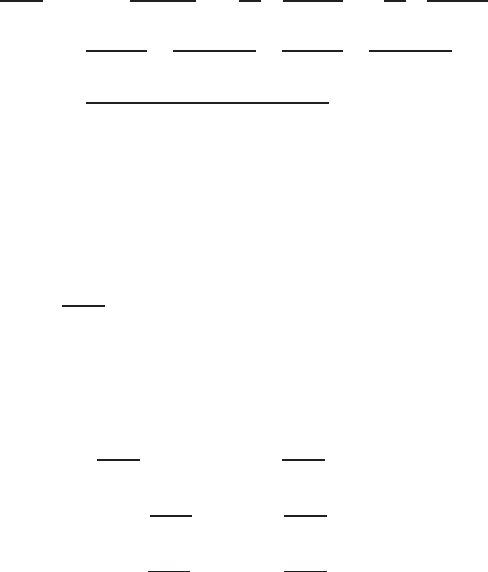
19.4 SOLUTIONS 1769
Since div ~
F= 0, we have
0 = ZB
~
F·d~
A−4π
ZB
~
F·d~
A=4π
25. (a) Since ~r =x
~
i+y~
j , for ~r 6=~
0,we have
div ~r
||~r ||2= div x
~
i+y~
j
x2+y2=∂
∂x x
x2+y2+∂
∂y y
x2+y2
=1
x2+y2−x·2x
(x2+y2)2+1
x2+y2−y·2y
(x2+y2)2
=x2+y2−2x2+x2+y2−2y2
(x2+y2)2
= 0.
(b) Since the cylinder contains points where ~r =~
0(on the z-axis) and div(~r /||~r ||2)is undefined there, we cannot use
the Divergence Theorem.
(c) Since the cylinder is closed, it is oriented outward. Calculating the flux directly, the flux through the ends of the
cylinder is 0 since the vector field has no ~
k-component. (The flux is zero even though the vector field is undefined on
the z-axis.) On the curved sides of the cylinder, the vector field is perpendicular to the surface and of length 1. Thus
Flux =ZS
~
r
||~r ||2·d~
A= 1 ·Area of curved side = 1 ·2π1·2 = 4π.
(d) The cylinder, S, in part (c) lies inside this one, S1.In the space, W, between the cylinders, the divergence is 0. The
surface of Wconsists of Soriented inward and S1oriented outward. The Divergence Theorem can be applied to the
region W, so
ZS1−S
~
r
||~r ||2·d~
A=ZW
div ~r
||~r ||2dV = 0
ZS1
~r
||~r ||2·d~
A−ZS
~
r
||~r ||2·d~
A= 0
ZS1
~r
||~r ||2·d~
A=ZS
~r
||~r ||2·d~
A= 4π.
Thus, the flux through this cylinder is the same as the flux through the cylinder in part (c).
26. We use the Divergence Theorem to compare the integrals. We have
div ~
F1=y2+ 3z2+ 3x2+ 2z2+ 3y2= 3x2+ 4y2+ 5z2
div ~
F2=y2+z2+x2
div ~
F3=z2+x2+z2+y2+y2+z2=x2+ 2y2+ 3z2.
For all x,y,z,
div ~
F2≤div ~
F3≤div ~
F1,
with equality only at the origin. Since the flux integrals are all through the same surface S, we have
ZS
~
F2·d~
A<ZS
~
F3·d~
A < ZS
~
F1·d~
A .
27. (a) By the Divergence Theorem, if Sis the surface of the rectangular solid W,
Flux =ZS
~
F·d~
A=ZW
div ~
F dV =Zc
0Zb
0Za
0
2(6 −x)dx dy dz
=Zc
0Zb
0
12x−x2
a
0
dy dz =cb(12a−a2).

1770 Chapter Nineteen /SOLUTIONS
(b) To maximize the flux cb(12a−a2), we take band cto be as large as possible and choose ato maximize (12a−a2)
on the interval 0≤a≤10. Thus we take a= 6,b=c= 10. Then
Flux =cb(12a−a2)a=6,b=10,c=10
= 3600.
28. (a) Since ~
Fis radial, it is everywhere parallel to the area vector, ∆~
A. Also, ||~
F|| = 1 on the surface of the sphere
x2+y2+z2= 1, so
Flux through the sphere =ZS
~
F·d~
A=lim
||∆~
A||→0X~
F·∆~
A
= lim
||∆~
A||→0X||~
F||||∆~
A|| = lim
||∆~
A||→0X||∆~
A||
=Surface area of sphere = 4π·12= 4π.
(b) In Cartesian coordinates,
~
F(x, y, z) = x
(x2+y2+z2)3/2~
i+y
(x2+y2+z2)3/2~
j+z
(x2+y2+z2)3/2~
k .
So,
div ~
F(x, y, z) = 1
(x2+y2+z2)3/2−3x2
(x2+y2+z2)5/2
+1
(x2+y2+z2)3/2−3y2
(x2+y2+z2)5/2
+1
(x2+y2+z2)3/2−3z2
(x2+y2+z2)5/2
=x2+y2+z2
(x2+y2+z2)5/2−3x2
(x2+y2+z2)5/2
+x2+y2+z2
(x2+y2+z2)5/2−3y2
(x2+y2+z2)5/2
+x2+y2+z2
(x2+y2+z2)5/2−3z2
(x2+y2+z2)5/2
=3(x2+y2+z2)−3(x2+y2+z2)
(x2+y2+z2)5/2
= 0.
(c) We cannot apply the Divergence Theorem to the whole region within the box, because the vector field ~
Fis not
defined at the origin. However, we can apply the Divergence Theorem to the region, W, between the sphere and the
box. Since div ~
F= 0 there, the theorem tells us that
Z
Box
(outward)
~
F·d~
A+Z
Sphere
(inward)
~
F·d~
A=ZW
div ~
F dV = 0.
Therefore, the flux through the box and the sphere are equal if both are oriented outward:
Z
Box
(outward)
~
F·d~
A=−Z
Sphere
(inward)
~
F·d~
A=Z
Sphere
(outward)
~
F·d~
A= 4π.

19.4 SOLUTIONS 1771
29. We have:
~
F(x, y, z) = x
~
i+y~
j+z~
k
(x2+y2+z2)3/2
Calculating the flux of ~
Fthrough the ellipsoid directly would be difficult. However, since div ~
F= 0, we can replace the
ellipsoid by a sphere. Except at the origin, we have div ~
F= 0.Let Tbe the surface of a sphere centered at the origin
inside the ellipsoid S, and let Wbe the region between Sand T. Suppose both Sand Tare oriented away from the origin.
By the Divergence Theorem, we have
Flux out of W=ZW
div ~
F·dV = 0,
and therefore
Flux out of W= (Flux out −Flux in) = ZS
~
F·d~
A−ZT
~
F·d~
A= 0.
Thus, we have
ZS
~
F·d~
A=ZT
~
F·d~
A=(Magnitude of ~
Fon sphere)·(Surface area)
=1
radius2·(4π·radius2) = 4π.
30. Use the Divergence Theorem. Since
~
F(x, y, z) = 1
(x2+y2+z2)3/2(x
~
i+y~
j+z~
k),
we have div ~
F= 0, except at the origin.
Let Tbe the surface of a sphere inside the cylinder S, and let Wbe the region between Sand T. By the Divergence
Theorem,
Flux out of W=ZS+T
~
F·d~
A=ZW
div ~
F dV = 0.
Since Sis oriented outward and Tis oriented inward,
Net flux out of W=Flux out −Flux in =ZS
~
F·d~
A−ZT
~
F·d~
A= 0.
so
ZS
~
F·d~
A=ZT
~
F·d~
A=Magnitude of ~
Fon sphere ·Surface area
=1
Radius2·(4πRadius2) = 4π.
31. (a) Let W1be the ball inside S1. By the Divergence Theorem,
ZS1
~
F·d~
A=ZW1
(x2+y2+z2+3) dV.
Using spherical coordinates, we have
ZS1
~
F·d~
A=ZW1
(x2+y2+z2+3) dV =Z2π
0Zπ
0Z1
0
(ρ2+3)ρ2sin φ dρ dφ dθ
= 2π·ρ5
5+ρ3
1
0
(−cos φ)
π
0
= 2π·6
5·2 = 24
5π.
(b) If we were to calculate all three integrals using the Divergence Theorem, we would be integrating div ~
Fthrough
the interior of each of these regions. Since S2lies entirely inside S3, and S3lies entirely inside S4, and since
div ~
F=x2+y2+z2+ 3 is positive everywhere,
ZS2
~
F·d~
A<ZS3
~
F·d~
A < ZS4
~
F·d~
A .
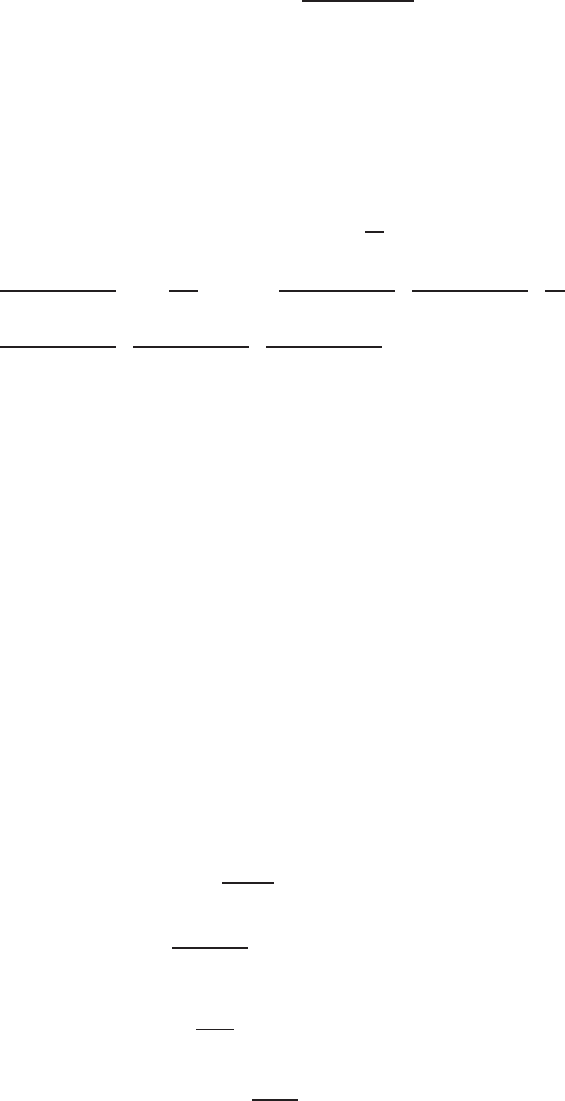
1772 Chapter Nineteen /SOLUTIONS
32. (a) At the point (1,2,1), we have div ~
F= 1 ·2·12= 2.
(b) Since the box is small, we use the approximation
div ~
F=Flux density ≈Flux out of box
Volume of box .
Thus
Flux out of box ≈(div ~
F)·(Volume of box) = 2(0.2)3= 0.016.
(c) To calculate the flux exactly, we use the Divergence Theorem,
Flux out of box =ZBox
div ~
F dV =ZBox
xyz2dV.
Since the box has side 0.2, it is given by 0.9< x < 1.1,1.9< y < 2.1,0.9< z < 1.1, so
Flux =Z1.1
0.9Z2.1
1.9Z1.1
0.9
xyz2dzdydx =Z1.1
0.9Z2.1
1.9
xy z3
3
1.1
0.9
dydx
=(1.1)3−(0.9)3
3Z1.1
0.9
xy2
2
2.1
1.9
dx =(1.1)3−(0.9)3
3·(2.1)2−(1.9)2
2·x2
2
1.1
0.9
=(1.1)3−(0.9)3
3·(2.1)2−(1.9)2
2·(1.1)2−(0.9)2
2= 0.016053 . . . .
Notice that you can calculate the flux without knowing the vector field, ~
F.
33. Any closed surface, S, oriented inward, will work. Then,
ZS(inward)
~
F·d~
A=−ZS(outward)
~
F·d~
A ,
so, by the Divergence Theorem, with Wrepresenting the region inside S,
ZS(inward)
~
F·d~
A=−ZW
div ~
F dV =−ZW
(x2+y2+ 3)dV.
The integral on the right is positive because the integrand is positive everywhere. Therefore the flux through Soriented
inward is negative.
34. (a) The rate at which heat is generated at any point in the earth is div ~
Fat that point. So div ~
F= 30 watts/km3.
(b) Differentiating gives div(α(x
~
i+y~
j+z~
k)) = α(1 + 1 + 1) = 3αso α= 30/3 = 10 watts/km3. Thus, ~
F=α~r
has constant divergence. Note that ~
F=α~r has flow lines going radially outward, and symmetric about the origin.
(c) The vector grad Tgives the direction of greatest increase in temperature. Thus, −grad Tgives the direction of
greatest decrease in temperature. The equation ~
F=−kgrad Tsays that heat will flow in the direction of greatest
decrease in temperature (i.e. from hot regions to cold), and at a rate proportional to the temperature gradient.
(d) We assume that ~
Fis given by the answer to part (b). Then, using part (c), we have
~
F= 10(x
~
i+y~
j+z~
k) = −30,000 grad T,
so
grad T=−10
30,000 (x
~
i+y~
j+z~
k).
Integrating we get
T=−10
2(30,000) (x2+y2+z2) + C.
At the surface of the earth, x2+y2+z2= 64002, and T= 20◦C, so
T=−1
6000 (64002) + C= 20.
Thus,
C= 20 + 64002
6000 = 6847.
At the center of the earth, x2+y2+z2= 0, so
T= 6847◦C.

19.4 SOLUTIONS 1773
35. (a) Using the expression given for the force, we have
Force in~
idirection =~
F·~
i=−ZS
δgz~
i·d~
A
=−δg ZS
z~
i·d~
A .
Now apply the Divergence Theorem to this integral. (Notice that in order to do this, you need to orient Soutward,
hence the minus sign disappears.)
~
F·~
i=δg ZV
∂z
∂x dV = 0.
Similarly:
Force in ~
jdirection =~
F·~
j=−δg ZS
z~
j·d~
A
=δg ZV
∂z
∂y dV = 0
(b)
Force in ~
kdirection =~
F·~
k=−δg ZS
z~
k·d~
A
=δgZV
∂z
∂z dV =δg ZV
dV =δgV.
36. (a) Taking partial derivatives of ~
Egives
∂E1
∂x =∂
∂x [qx(x2+y2+z2)−3/2] = q[(x2+y2+z2)−3/2+x(−3/2)(2x)(x2+y2+z2)−5/2]
=q(y2+z2−2x2)(x2+y2+z2)−5/2.
Similarly,
∂E2
∂x =q(x2+z2−2y2)(x2+y2+z2)−5/2
∂E3
∂x =q(x2+y2−2z2)(x2+y2+z2)−5/2.
Summing, we obtain div ~
E= 0.
(b) Since on the surface of the sphere, the vector field ~
Eand the area vector ∆~
Aare parallel,
~
E·∆~
A=k~
Ekk∆~
Ak.
Now, on the surface of a sphere of radius a,
k~
Ek=qk~r k
k~r k3=q
a2.
Thus, ZSa
~
E·d~
A=Zq
a2kd~
Ak=q
a2·Surface area of sphere =q
a2·4πa2= 4πq.
(c) It is not possible to apply the Divergence Theorem in part (b) since ~
Eis not defined at the origin (which lies inside
the region of space bounded by Sa), and the Divergence Theorem requires that the vector field be defined everywhere
inside S.
(d) Let Rbe the solid region lying between a small sphere Sa, centered at the origin, and the surface S. Applying the
Divergence Theorem and the result of part (a), we get:
0 = ZR
div ~
E dV =ZSa
~
E·d~
A+ZS
~
E·d~
A ,
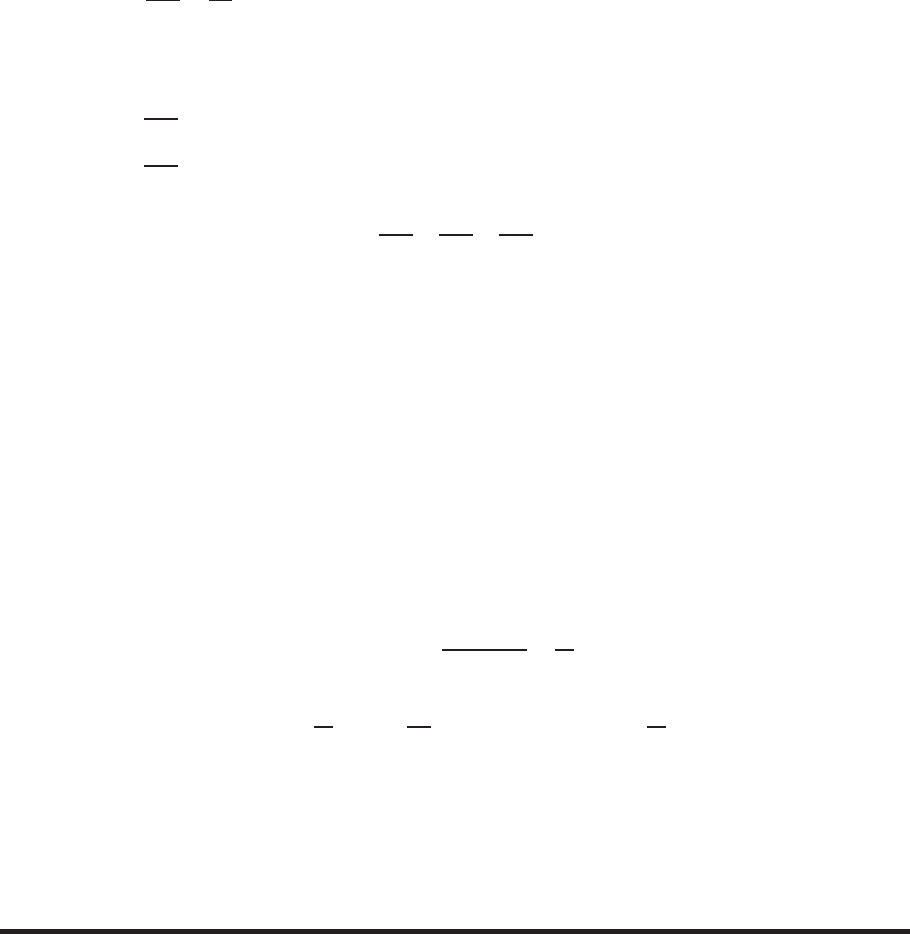
1774 Chapter Nineteen /SOLUTIONS
where Sis oriented with the outward normal vector, and Sawith the inward normal vector (since this is “outward”
with respect to the region R). Since
ZSa,inward
~
E·d~
A=−ZSa,outward
~
E·d~
A ,
the result of part (b) yields ZS
~
E·d~
A= 4πq.
[Note: It is legitimate to apply the Divergence Theorem to the region Rsince the vector field ~
Eis defined everywhere
in R.]
37. Check that div ~
E= 0 by taking partial derivatives. For instance,
∂E1
∂x =∂
∂x [q(x−x0)[(x−x0)2+ (y−y0)2+ (z−z0)2]−3/2]
=q[(y−y0)2+ (z−z0)2−2(x−x0)2][(x−x0)2+ (y−y0)2+ (z−z0)2]−5/2
and similarly,
∂E2
∂y =q[(x−x0)2+ (z−z0)2−2(y−y0)2][(x−x0)2+ (y−y0)2+ (z−z0)2]−5/2
∂E3
∂z =q[(x−x0)2+ (y−y0)2−2(z−z0)2][(x−x0)2+ (y−y0)2+ (z−z0)2]−5/2.
Therefore, ∂E1
∂x +∂E2
∂y +∂E3
∂z = 0.
The vector field ~
Eis defined everywhere but at the point with position vector ~r 0. If this point lies outside the surface S,
the Divergence Theorem can be applied to the region Renclosed by S, yielding:
ZS
~
E·d~
A=ZR
div ~
E dV = 0.
If the charge qis located inside S, consider a small sphere Sacentered at qand contained in R. The Divergence Theorem
for the region R′between the two spheres yields:
ZS
~
E·d~
A+ZSa
~
E·d~
A=ZR′
div ~
EdV = 0.
In this formula, the Divergence Theorem requires Sto be given the outward orientation, and Sathe inward orientation. To
compute RSa
~
E·d~
A , we use the fact that on the surface of the sphere, ~
Eand ∆~
Aare parallel and in opposite directions,
so ~
E·∆~
A=−k~
Ekk∆~
Ak
since on the surface of a sphere of radius a,
k~
Ek=qk~r −~r 0k
k~r −~r 0k3=q
a2.
Then, ZSa
~
E·d~
A=Z−q
a2kd~
Ak=−q
a2·Surface area of sphere =−q
a2·4πa2=−4πq.
ZSa
~
E·d~
A=−4πq.
ZS
~
E·d~
A−ZSa
~
E·d~
A= 4πq.
Strengthen Your Understanding
38. The surface Sis not the boundary of a solid region, so the Divergence Theorem does not apply.

19.4 SOLUTIONS 1775
39. The correct statement of the Divergence Theorem is:
ZS
~
F·d~
A=ZW
div ~
F dV.
40. Since div ~
F= 0 everywhere, the Divergence Theorem shows that
ZS
~
F·d~
A=ZW
div ~
F dV = 0
for every surface Sthat bounds a solid region W. For example, we can take Sto be a sphere with any center and radius.
41. If Sis a sphere of radius 1 centered at the origin and Wis the region inside it, then
Flux out of S=ZS
~
FdA =ZW
div ~
F dV = 3.
We pick ~
Fto be a vector field with constant divergence, div ~
F=k, and calculate the constant kso as to get a flux of 3.
Let ~
F=kx
~
i. Then div ~
F=keverywhere and
Flux out of S=ZW
kdV =k·(Volume of the sphere) = 4
3πk.
So we have
Flux out of S=4
3πk = 3,which gives k=9
4π.
Thus, ~
F= (9x/4π)
~
iis one possible answer.
42. False. Since the divergence is positive, ~
Fhas a net outflow per unit volume everywhere.
43. True. The divergence of the field x
~
i+ (3y)~
j+ (y−5x)~
kis equal to 1 + 3 + 0 = 4 at all points.
44. False. The divergence of any constant field is zero at all points.
45. False. The vector field could be ~
F= 4x
~
i, which is parallel to the xy-plane and hence has zero flux through the circle.
Note that the Divergence Theorem cannot be used to calculate the flux in this case since a circle is not a closed surface
enclosing a volume.
46. True. The Divergence Theorem applies in this case and, since div ~
Fis constant, the flux of ~
Fthrough the cylinder is
equal to 4 times the volume of the cylinder, or 4(3π).
47. False. If this were true, div ~
F, which is a function, would always be constant (RS~
F·d~
Ais a constant). Take ~
F=x2
~
i,
so div ~
F= 2x, which is not constant.
48. False. Neither side of this equation makes sense: div ~
Fis a scalar, and we cannot take the flux integral of a scalar. On the
other side, ~
Fis a vector field, and we cannot take the triple integral of a vector field.
49. True. By the Divergence theorem, RS~
F·d~
A=−RWdiv ~
F dV , where Wis the solid interior of Sand the negative
sign is due to the inward orientation of S. Since div ~
F= 0, we have RS~
F·d~
A= 0.
50. True. By the Divergence theorem, RS~
F·d~
A=RWdiv ~
F dV , where Wis the solid interior of S. Since div ~
F= 1,
we have RS~
F·d~
A=RW1dV which is equal to the volume enclosed by S.
51. True. The Divergence theorem says that RWdiv ~
F dV =RS~
F·d~
A, where Sis the outward oriented boundary of W.
In this case, the boundary of Wconsists of the surfaces S1and S2. To give this boundary surface a consistent outward
orientation, we use a normal vector on S1that points toward the origin, and a normal on S2that points away from the
origin. Thus RWdiv ~
F dV =RS2
~
F·d~
A+RS1
~
F·d~
A, with S2oriented outward and S1oriented inward. Reversing
the orientation on S1so that both spheres are oriented outward yields RWdiv ~
F dV =RS2
~
F·d~
A−RS1
~
F·d~
A .
52. False. The boundary of the cube Wconsists of six squares, so the Divergence theorem requires adding the flux integrals
over the four remaining sides.
53. True. The boundary of the cube Wconsists of six squares, but four of them are parallel to the xz or yz-planes and so
contribute zero flux for this particular vector field. The only two surfaces of the boundary with nonzero flux are S1and
S2, which are parallel to the xy-plane.

1776 Chapter Nineteen /SOLUTIONS
54. False. The Divergence theorem tells us in this case that RS~
F·d~
A=RWdiv ~
F dV = 0,where Wis the solid ball with
boundary S. But this does not necessarily mean that div ~
F= 0 at all points in W. The divergence of ~
Fcan be positive
at some points in Wand negative at other points in W, yielding a triple integral of zero. For example, let ~
F=x2
~
i.
The flux of this vector field through the sphere is 0. (The flux out for x > 0cancels the flux in for x < 0.) However,
div ~
F= 2x, which is not 0.
55. True. Let Dbe the disk that forms the bottom of the cylinder, x2+y2≤1, z = 0,oriented downward. Then the surface
consisting of Shand Dis closed and oriented outward, so the Divergence Theorem says RSh+D~
F·d~
A=RWdiv ~
F dV ,
where Wis the solid interior of the cylinder. Since div ~
F= 0, we have RSh+D~
F·d~
A= 0.Writing the flux integral
as the sum of integrals over Shand Dgives RSh
~
F·d~
A+RD~
F·d~
A=0,so RSh
~
F·d~
A=−RD~
F·d~
A. The flux
integral RD~
F·d~
Adoes not depend on the height h, so RSh
~
F·d~
Ais independent of h.
56. Since div ~
F= 5 + 7 + 9 = 21, by the Divergence Theorem, if Wiis the region inside Si, we have
Qi=ZWi
21 dV = 21 ·Vol Wi.
Thus, we arrange Qiby the volume of Wi, so
Q4< Q3< Q2< Q1.
Solutions for Chapter 19 Review
Exercises
1. Scalar. Only the ~
j-component of the vector field contributes to the flux and d~
A=−~
j dA, so
ZS
(3
~
i+ 4~
j)·d~
A=−4·Area of disk =−4·π52=−100π.
2. Scalar. Since
div y~
i−x~
j
x2+y2=−y·2x
(x2+y2)2+x·2y
(x2+y2)2= 0.
3. (a) Only the~
i-component of the vector field contributes to the flux and d~
A=~
i dA, so
ZS
(
~
i+ 2~
j+~
k)·d~
A= 1 ·Area of square = 16.
(b) Only the~
i-component of the vector field contributes to the flux and d~
A=~
i dA, so
ZS
(
~
i+2~
j+~
k)·d~
A= 1 ·Area of square = 16.
(c) Only the ~
k-component of the vector field contributes to the flux and d~
A=−~
k dA, so
ZS
(
~
i+2~
j+~
k)·d~
A=−1·Area of square =−16.
(d) Only the ~
k-component of the vector field contributes to the flux and d~
A=−~
k dA, so
ZS
(
~
i+2~
j+~
k)·d~
A=−1·Area of square =−16.
(e) Only the ~
j-component of the vector field contributes to the flux and d~
A=~
j dA, so
ZS
(
~
i+ 2~
j+~
k)·d~
A= 2 ·Area of square = 32.

SOLUTIONS to Review Problems for Chapter Nineteen 1777
4. Zero, since d~
Ais parallel to the x-axis, so (x~
j+y~
k)·d~
A= 0.
5. Negative. On S, we have d~
A=−~
i dy dz and x= 7, so (x
~
i+y~
k)·d~
A=−7dy dz. Thus, the flux integral is negative.
6. Zero. Since d~
A=−~
i dA, we have ZS
(y~
i+x~
k)·d~
A=−ZS
ydA = 0.
The integral is 0 because the disk is centered on the x-axis, so the contributions from the parts of the disk where yis
positive and where yis negative cancel. In more detail, since d~
A=−~
i dx dy on S, we have
ZS
(y~
i+x~
k)·d~
A=ZS−ydx dy = 0.
7. Positive. Since d~
A=−~
i dA and (x−10) = −3on S,
ZS
((x−10)
~
i+ (x+ 10)~
j)·d~
A=Z(−3
~
i+ (x+ 10)~
j)·(−~
i dA) = ZS
3dA = 3 ·Area of S.
8. The disk has area 25π, so its area vector is 25π~
j. Thus
Flux = (2
~
i+ 3~
j)·25π~
j= 75π.
9. Since ~
Fis a constant vector field, the flux through a closed surface is zero. (The flux that enters one side, exits the other
side.)
10. The square has area 16, so its area vector is 16~
j. Since ~
F= 5~
jon the square,
Flux = 5~
j·16~
j= 80.
11. The square has area 9, so its area vector is 9
~
i. Since ~
F=−5
~
ion the square,
Flux =−5
~
i·9
~
i=−45.
12. Since the square, S, is in the plane y= 0 and oriented in the negative y-direction, d~
A=−~
j dxdz and
ZS
~
F·d~
A=ZS
(0 + 3)~
j·(−~
j dxdz) = −3ZS
dxdz =−3·Area of square =−3(22) = −12.
13. Since the square, S, is oriented upward, d~
A=~
k dxdy and
Flux =ZS
~
F·d~
A=ZS
x~
k·~
kdxdy =Z3
0Z3
0
xdxdy =Z3
0
x2
2
3
0
dy=9
2Z3
0
dy=27
2.
14. Since the vector field is constant, Flux = 0. The flux through opposite faces of the cube cancel.
15. The only contribution to the flux is from the ~
k-component, and since the square, S, is oriented upward, we have
Flux =ZS
(6
~
i+x2~
j−~
k)·d~
A=ZS−~
k·d~
A=−Area of square =−4.
16. All the vectors in the vector field point horizontally (because their z-component is zero), and the surface is horizontal, so
there is no flow through the surface and the flux is zero.
17. We have d~
A=~
k dA, so
ZS
~
F·d~
A=ZS
(z~
i+y~
j+2x~
k)·~
k dA =ZS
2x dA
=Z3
0Z2
0
2x dxdy = 12.
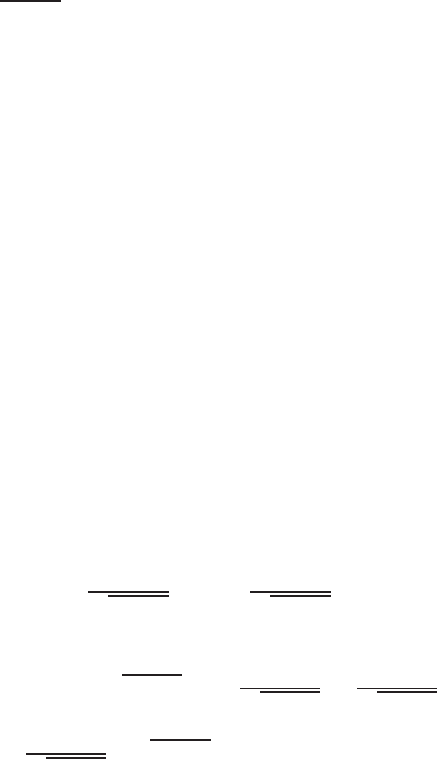
1778 Chapter Nineteen /SOLUTIONS
18. We have d~
A=~
i dA, so
ZS
~
F·d~
A=ZS
((2 + cos z)
~
i+y~
j+ 2x~
k)·~
i dA =ZS
(2 + cos z)dA
=Z4
0Z3
0
(2 + cos z)dydz = 3(8 + sin 4)
19. On the surface S,yis constant, y=−1, and d~
A=−~
j dA, so,
ZS
~
F·d~
A=ZS
(x2
~
i+(x+e−1)~
j−~
k)·(−~
j)dA =−ZS
(x+e−1)dA
=−Z4
0Z2
0
(x+e−1)dx dz =−4(2 + 2e−1) = −8(1 + e−1).
20. Observe that the ~
jand ~
kcomponents of ~
Fare parallel to the surface S, so they contribute nothing to the flux integral.
On the surface S, the~
icomponent of ~
Fequals 5
~
i, because x= 0 on S. Since 5
~
iis normal to Sand in the direction of
the orientation of S,RS~
F·d~
A=RS5
~
i·d~
A=k5
~
ik(Area of S) = 20.
21. There is no flux through the base or top of the cylinder because the vector field is parallel to these faces. For the curved
surface, consider a small patch with area ∆~
A. The vector field is pointing radially outward from the z-axis and so is
parallel to ∆~
A. Since k~
Fk=px2+y2= 2 on the curved surface of the cylinder, we have ~
F·∆~
A=k~
Fkk∆~
Ak=
2∆A. Replacing ∆Awith dA, we get
ZS
~
F·d~
A=ZCurved
surface
2dA = 2(Area of curved surface) = 2(2π·2·3) = 24π.
22. The vector field ~
F=−y~
i+x~
j+z~
kis tangent to the curved surface of the cylinder. (The area vector is parallel to the
vector pointing radially outward from the z-axis, namely x
~
i+y~
jand (−y~
i+x~
j+z~
k)·(x
~
i+y~
j) = 0.) Thus the
only contributions to the flux integral are from the top and the bottom. On the top, z= 1 and d~
A=dA~
k, so
~
F·d~
A= (−y~
i+x~
j+~
k)·dA~
k=dA.
Thus ZTop
~
F·d~
A=ZTop
dA=Area of top =π(1)2=π.
Similarly, on the base, z=−1and d~
A= (−dA ~
k), so
~
F·d~
A= (−y~
i+x~
j−~
k)·(−dA~
k) = dA.
ZBase
~
F·d~
A=ZBase
dA=Area of base =π.
Therefore,
Total flux through cylinder =Flux through top +Flux through base = 2π.
23. First we have
zx=x
px2+y2zy=y
px2+y2.
Although zis not a smooth function of xand yat (0,0), the improper integral that we get converges:
ZS
~
F·d~
A=ZS
(x2
~
i+y2~
j+px2+y2~
k)·(−x
px2+y2
~
i−y
px2+y2
~
j+~
k)dA
=ZS −x3+y3
px2+y2+px2+y2!dA
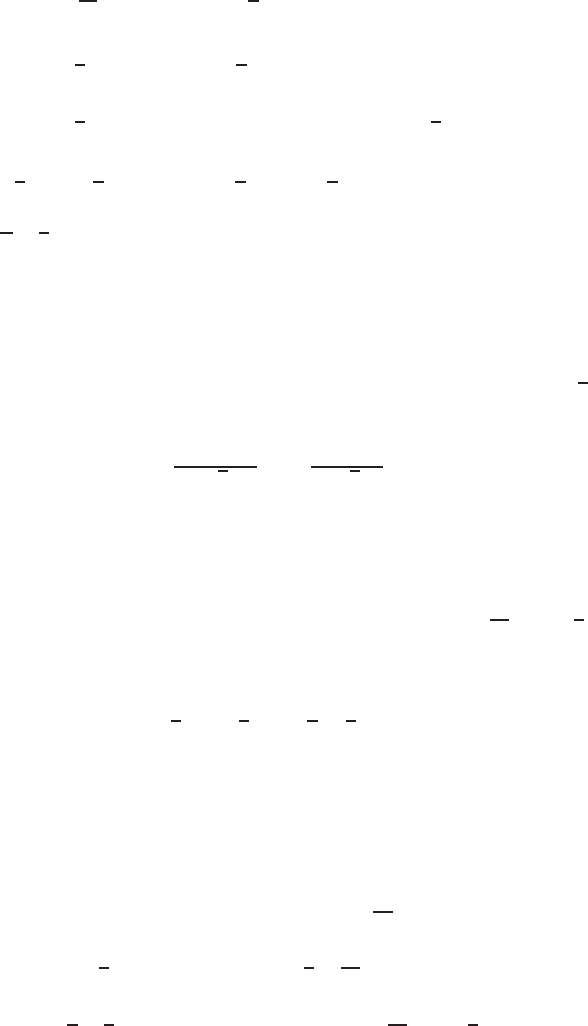
SOLUTIONS to Review Problems for Chapter Nineteen 1779
Changing to polar coordinates we have
ZS
~
F·d~
A=Zπ/2
0Z1
0
(−r2cos3θ−r2sin3θ+r)r drdθ
=Zπ/2
0 −r4
4(cos3θ+ sin3θ) + 1
3r3
r=1
r=0!dθ
=Zπ/2
0−1
4(cos3θ+ sin3θ) + 1
3dθ
=Zπ/2
0−1
4(cos θ−cos θsin2θ+ sin θ−sin θcos2θ) + 1
3dθ
=−1
4(sin θ−1
3sin3θ−cos θ+1
3cos3θ) + θ
3
π/2
0
=π
6−1
3.
24. The vector normal to Sis ~
j; the dot product of ~
Fand ~
jis positive if b > 0. There are no conditions on aand c.
25. By the symmetry of the sphere, the ~
iand ~
jcomponents of ~
Fdo not contribute to the flux; only the ~
kcomponent
contributes. The vector normal to Shas a negative ~
kcomponent, so we need c > 0. There are no conditions on aand b.
26. The sphere is oriented outward. Provided a > 0, the vector field points outward, giving positive flux.
27. The normal to the plane is~
i+~
j+~
k. Converting this to a unit vector, we see that on the plane d~
A= (
~
i+~
j+~
k)/√3dA.
The flux integrates the dot product
~
F·d~
A= (a
~
i+b~
j+c~
k)·~
i+~
j+~
k
√3dA =a+b+c
√3dA.
Thus we need a+b+c > 0.
28. (a) By direct calculation, the flux of ~
Fthrough the plane x= 0 is 0because the ~
i-component of the vector field is 0
there. The flux of ~
Fthrough S, the square 0≤y≤1,0≤z≤1in the plane x= 1 is
Flux =ZS
~
F·d~
A=Z1
0Z1
0
(1·y~
i+yz~
j+z·1~
k)·~
i dy dz =Z1
0Z1
0
y dy dz =Z1
0
y2
2
1
0
dz=1
2.
Similarly, the faces y= 0 and y= 1 contribute a flux of 0and 1/2, respectively, as do the faces z= 0 and z= 1.
Therefore
Total flux = 0 + 1
2+ 0 + 1
2+ 0 + 1
2=3
2.
(b) Since div ~
F=y+z+x, the flux is given by
ZBox
~
F·d~
A=ZBox
(x+y+z)dV.
We calculate the integral
ZBox
(x+y+z)dV=Z1
0Z1
0Z1
0
(x+y+z)dx dy dz =Z1
0Z1
0x2
2+yx +zx
1
0
dy dz
=Z1
0Z1
01
2+y+zdy dz =Z1
0y
2+y2
2+zy
1
0
dz
=Z1
01
2+1
2+zdz =Z1
0
(1 + z)dz =z+z2
2
1
0
=3
2.

1780 Chapter Nineteen /SOLUTIONS
29. (a) We will compute separately the flux of the vector field ~
F=x3
~
i+ 2y~
j+ 3~
kthrough each of the six faces of the
cube.
The face SIwhere x= 1, which has normal vector ~
i. Only the ~
icomponent x3
~
i=~
iof ~
Fhas flux through
SI.
ZSI
~
F·d~
A=ZSI
~
i·d~
A=k~
ik(area of SI) = 4.
The face SII where x=−1, which has normal vector −~
i. Only the ~
icomponent x3
~
i=−~
iof ~
Fhas flux
through SII .
ZSII
~
F·d~
A=ZSII −~
i·d~
A=k−~
ik(area of SII ) = 4.
The face SIII where y= 1, which has normal vector ~
j. Only the ~
jcomponent 2y~
j= 2~
jof ~
Fhas flux
through SIII.
ZSIII
~
F·d~
A=ZSIII
2~
j·d~
A=k2~
jk(area of SIII) = 8.
The face SIV where y=−1, which has normal vector −~
j. Only the ~
jcomponent 2y~
j=−2~
jof ~
Fhas flux
through SIV .
ZSIV
~
F·d~
A=ZSIV −2~
j·d~
A=k−2~
jk(area of SIV ) = 8.
The face SVwhere z= 1, which has normal vector ~
k. Only the ~
kcomponent 3~
kof ~
Fhas flux through SV.
ZSV
~
F·d~
A=ZSV
3~
k·d~
A=k3~
kk(area of SV) = 12.
The face SV I where z=−1, which has normal vector −~
k. Only the ~
kcomponent 3~
kof ~
Fhas flux through
SV I .
ZSV I
~
F·d~
A=ZSV I
3~
k·d~
A=−k3~
kk(area of SV I ) = −12.
(Total flux through S) = 4 + 4 + 8 + 8 + 12 −12 = 24.
(b) Since Sis a closed surface the Divergence Theorem applies. Since div ~
F= 3x2+ 2,
ZS
~
F·d~
A=Z1
x=−1Z1
y=−1Z1
z=−1
(3x2+ 2)dzdydx = 24.
30. Since div ~
F=−1 + 2 + 2 = 3, we use the Divergence Theorem:
Flux =ZS
~
F·d~
A=ZW
div ~
F dV = 3 ·Volume of Sphere = 3 ·4
3π23= 32π.
31. Since div ~
F= 2 + 3 + 4 = 9,the Divergence Theorem gives
ZS
~
F·d~
A=ZInterior
of sphere
div ~
F dV = 9 ·Volume of sphere = 9 ·4
3π53= 1500π.
32. Since div ~
F= 2x+ 2y, the Divergence Theorem gives
ZS
~
F·d~
A=ZInterior
of cube
(2x+ 2y)dV
= 2 Z3
0Z3
0Z3
0
(x+y)dx dy dz
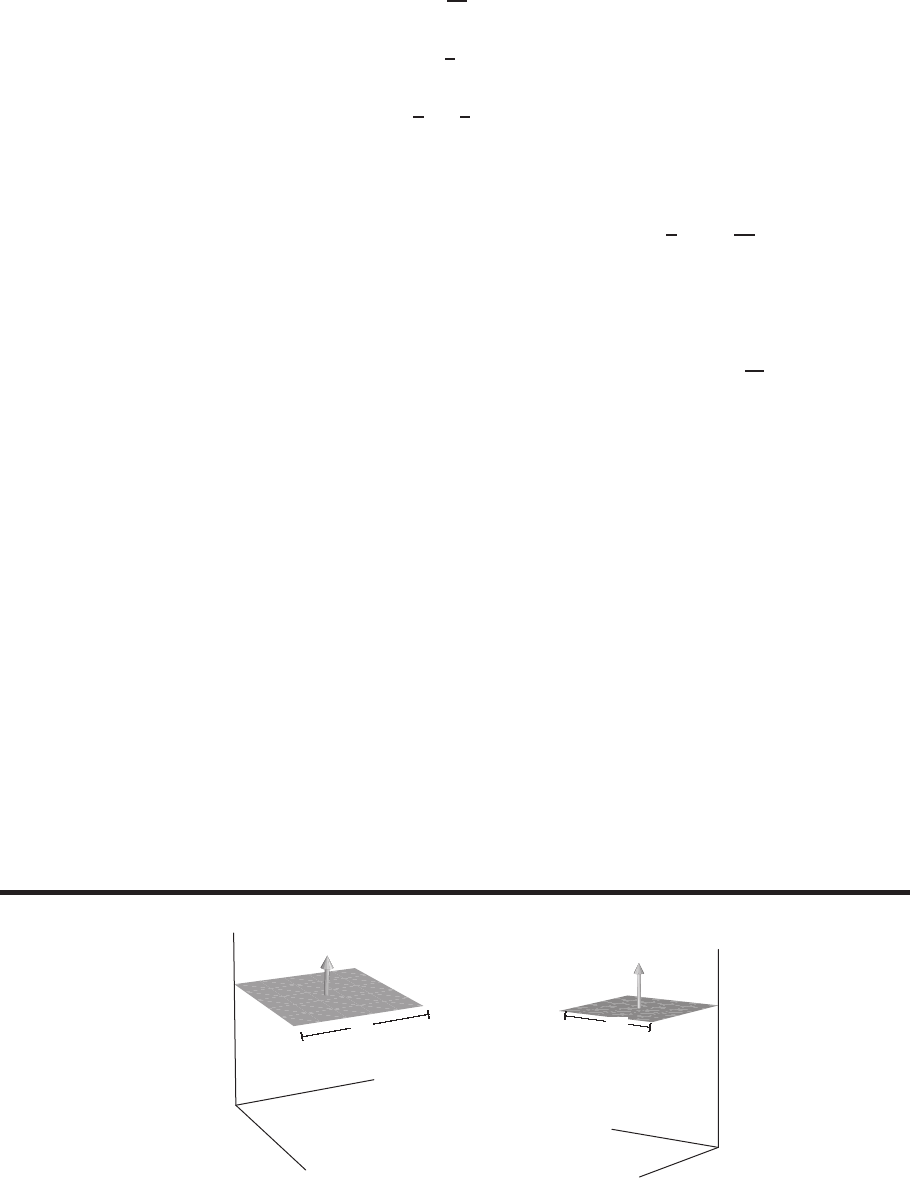
SOLUTIONS to Review Problems for Chapter Nineteen 1781
= 2 Z3
0Z3
0x2
2+xy
3
0
dy dz
= 2 Z3
0Z3
09
2+ 3ydy dz
= 2 Z3
09
2y+3
2y2
3
0
dz = 2 Z3
0
27 dz = 162.
33. Since div ~
F= 1 + 2 −1 = 2,the Divergence Theorem gives
ZS
~
F·d~
A=ZInterior
of sphere
div ~
F dV = 2 ·Volume of sphere = 2 ·4
3π13=8π
3.
34. Since div ~
F= 3x2+ 3y2,using cylindrical coordinates to calculate the triple integral gives
ZS
~
F·d~
A=ZInterior
of cylinder
(3x2+ 3y2)dV = 3 Z2π
0Z5
0Z2
0
r2·r dr dz dθ = 3 ·2π·5r4
4
2
0
= 120π.
35. Since div ~
F= 1 + 1 + 1 = 3, the flux through the closed cylinder, S1, with interior W, is
ZS1
~
F·d~
A=ZW
3dV= 3 ·Volume of cylinder = 3π.
With the base of the cylinder oriented downward and the top of the cylinder oriented upward,
ZS
~
F·d~
A=ZS1
~
F·d~
A−ZBase
~
F·d~
A−ZTop
~
F·d~
A.
Since ~
Fis parallel to the base, the flux through the base is 0. The flux through the top is contributed entirely by the ~
k
component. Since z= 1, we have
Flux through top =ZTop
~
F·d~
A=ZTop
(x
~
i+y~
j+~
k)·d~
A=ZTop
~
k·d~
A=π.
Thus ZS
~
F·d~
A= 3π−π= 2π.
Problems
36.
x
y
z
S1
(0,0,2)
✛
✛
1
Figure 19.22
z
−x
−y
S2
(0,0,3)
✛
✛
1
Figure 19.23
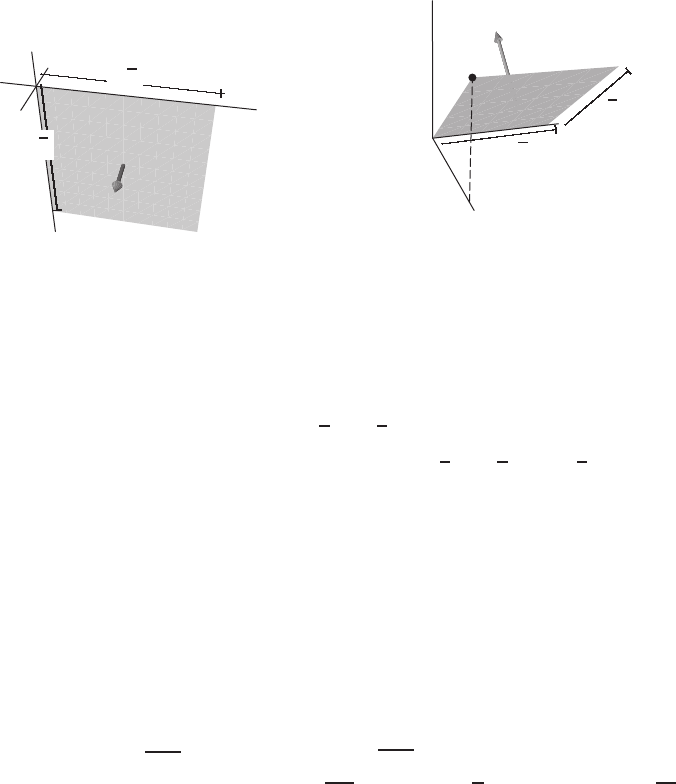
1782 Chapter Nineteen /SOLUTIONS
x
y
z
S3
✛
✛
✛
✛
√2
√2
Figure 19.24
x
y
z
(1,0,1)
✛
✛
√2
✛
✛
√2
Figure 19.25
Flux through S1=~
F·~
A= (−~
i−~
j+~
k)·(~
k) = 1
Flux through S2=~
F·~
A= (−~
i−~
j+~
k)·(~
k) = 1
Flux through S3=~
F·~
A= (−~
i−~
j+~
k)·(−2~
j) = 2
For S4, a normal is −~
i+~
kand the area is 2, so ~
A=−√2
~
i+√2~
k
Flux through S4=~
F·~
A= (−~
i−~
j+~
k)·(−√2
~
i+√2~
k) = 2√2.
So,
Flux through S1=Flux through S2<Flux through S3<Flux through S4.
37. (a) We have grad f= (y+yzexyz)
~
i+ (x+xzexyz)~
j+xyexyz~
k .
(b) By the Fundamental Theorem of Line Integrals, we have
ZC
grad f·d~r = (xy +exyz)
(2,3,4)
(1,1,1)
= (2 ·3 + e2·3·4−(1 ·1 + e1·1·1) = 5 + e24 −e1.
(c) Only the k-component of grad fcontributes to the flux integral. On the xy-plane, d~
A=~
k dx dy and z= 0, so
ZS
grad f·d~
A=Z2
0Z√4−x2
0
xye0dy dx =Z2
0
xy2
2
√4−x2
0
=Z2
0
x
2(4 −x2)dx =x2−x4
8
2
0
= 2.
38. The square of side 2 in the plane x= 5, oriented in the positive x-direction, has area vector ~
A= 4
~
i. Since the vector
field is constant
Flux = (a
~
i+b~
j+c~
k)·4
~
i= 4a= 24.
Thus, a= 6 and we cannot say anything about the values of band c.
39. (a) In the first and third integrals, only the~
icomponent contributes to the flux integral. The orientation is in the positive
~
idirections in both cases, the disks are the same size, and the (x2+ 4) is larger on the surface S3, so the flux through
S3is larger than the flux through S1. In the case of S2, only the ~
j-component contributes. Since the disks in S2and
S3are the same size, and S2oriented in the positive y-direction, the fact that (x2+ 4) is larger on S3than yis on S2
tells us that the flux through S3is largest.
(b) On S3, the vector field is ((−3)2+ 4)
~
i+y~
j= 13
~
i+y~
jand d~
A=~
i dA, so
ZS3
((x2+4)
~
i+y~
j)·d~
A=ZS3
(13
~
i+y~
j)·~
i dA =ZS3
13 dA = 13 ·Area of disk = 13π.
40. (a) At the north pole, the area vector of the plate is upward (away from the center of the earth), and so is in the opposite
direction to the magnetic field. Thus the magnetic flux is negative.
(b) At the south pole, the area vector of the plate is again away from the center of the earth (because that is upward in the
southern hemisphere), and so is in the same direction as the magnetic field. Thus, the magnetic flux is positive.
(c) At the equator the magnetic field is parallel to the plate, so the flux is zero.

SOLUTIONS to Review Problems for Chapter Nineteen 1783
41. (a) By the definition of divergence as flux density, we have
Flux out of small region ≈Divergence ·Volume.
(i) At (2,1,1), we have div ~
F= 22+ 12−12= 4, so
Flux ≈4·4
3π(0.1)3=0.016
3π= 0.0168.
(ii) At (0,0,1), we have div ~
F= 02+ 02−12=−1, so
Flux ≈ −1·4
3π(0.1)3=−0.004.
(b) The fact that the flux in part (i) is positive tells us that the vector field is pointing, on average, outward (rather than
inward) on the sphere around (2,1,1). The fact that the flux in part (ii) is negative tells us that, on average, the vector
field is pointing inward (rather than outward) on the sphere around the point (0,0,1).
42. (a) The cube is in Figure 19.26. The vector field is parallel to the x-axis and zero on the yz-plane. Thus the only
contribution to the flux is from S2. On S2, x =c, the normal is outward. Since ~
Fis constant on S2, the flux through
face S2is
ZS2
~
F·d~
A=~
F·~
AS2
=c
~
i·c2
~
i
=c3.
Thus, total flux through box =c3.
(b) Using the geometric definition of divergence
div ~
F= lim
c→0Flux through box
Volume of box
= lim
c→0c3
c3
= 1
(c) Using partial derivatives,
div ~
F=∂
∂x (x) + ∂
∂y (0) + ∂
∂z (0) = 1 + 0 + 0 = 1.
x
y
z
S2
S6
S3
❄
S1
(back)
■S5
(bottom)
✛S4
(back)
Figure 19.26

1784 Chapter Nineteen /SOLUTIONS
43. See Figure 19.26.
(a) Since 2
~
i+ 3~
kis a constant field, its contribution to the flux is zero (flux in cancels flux out). Therefore R~
F·d~
A=
R(y~
j)·d~
A=RS3y~
j·d~
A+RS4y~
j·d~
Asince only S3and S4are perpendicular to y~
j. On S3,y= 0 so
RS3y~
j·d~
A=0. On S4,y=cand normal is in the positive y-direction, so RS4y~
j·d~
A=c(Area of S4) =
c·c2=c3. Thus, total flux =c3.
(b) Using the geometric definition of divergence
div ~
F= lim
c→0Flux through box
Volume of box
= lim
c→0c3
c3= 1.
(c)
∂
∂x (2) + ∂
∂y (y) + ∂
∂z (3) = 0 + 1 + 0 = 1.
44. See Figure 19.26.
(a) This vector field points radially outward from the z-axis. Thus, the vector field is parallel to the surface on S1, S3, S5
and S6, so the only contributions to the flux integral are from S2and S4.
On S2, x =cand normal is in the positive x-direction, so the flux is
ZS2
~
F·d~
A=ZS2
(c
~
i+y~
j)·(dA
~
i) = ZS2
c dA =c(Area of S2) = c3.
Similarly, the flux through S4is
ZS4
~
F·d~
A=ZS4
(x
~
i+c~
j)·(dA~
j) = ZS4
c dA =c(Area of S4) = c3.
Thus, the total flux through the box = 2c3.
(b) Using the geometric definition of divergence, we have
div ~
F= lim
c→0Flux through surface of box
Volume of box
= lim
c→02c3
c3= 2.
(c)
∂
∂x (x) + ∂
∂y (y) + ∂
∂z (0) = 1 + 1 + 0 = 2.
45. We close the cylinder, S, by adding the circular disk, S1, at the top, z= 3. The surface S+S1is oriented outward, so S1
is oriented upward. Applying the Divergence Theorem to the closed surface S+S1enclosing the region W, we have
ZS+S1
~
F·d~
A=ZW
div ~
F dV
ZS
~
F·d~
A+ZS1
~
F·d~
A=Zdiv ~
F dV.
Since
div ~
F= div(z2
~
i+x2~
j+ 5~
k) = 0,
we have ZS
~
F·d~
A=−ZS1
~
F·d~
A.
Only the ~
k-component of ~
Fcontributes to the flux through S1, and d~
A=~
k dx dy on S1, so
ZS
~
F·d~
A=−ZS1
(z2
~
i+x2~
j+5~
k)·~
k dx dy =−ZS1
5dx dy =−5·Area of S1=−5π(√2)2=−10π.

SOLUTIONS to Review Problems for Chapter Nineteen 1785
46. We close the cylinder, S, by adding the circular disk, S1, at the top, z= 3. The surface S+S1is oriented outward, so S1
is oriented upward. Applying the Divergence Theorem to the closed surface S+S1enclosing the region W, we have
ZS+S1
~
F·d~
A=ZW
div ~
F dV
ZS
~
F·d~
A+ZS1
~
F·d~
A=Zdiv ~
F dV.
Since
div ~
F= div(y2
~
i+z2~
j+ (x2+y2)~
k) = 0,
we have ZS
~
F·d~
A=−ZS1
~
F·d~
A.
Only the ~
k-component of ~
Fcontributes to the flux through S1, and d~
A=~
k dx dy on S1, so
ZS
~
F·d~
A=−ZS1
(y2
~
i+z2~
j+(x2+y2)~
k)·~
k dx dy =−ZS1
(x2+y2)dx dy.
Converting to polar coordinates, since the cylinder has radius √2, we have
ZS
~
F·d~
A=−Z2π
0Z√2
0
r2·r dr dθ =−2πr4
4
√2
0
=−2π.
47. We close the cylinder, S, by adding the circular disk, S1, at the top, z= 3. The surface S+S1is oriented outward, so S1
is oriented upward. Applying the Divergence Theorem to the closed surface S+S1enclosing the region W, we have
ZS+S1
~
F·d~
A=ZW
div ~
F dV
ZS
~
F·d~
A+ZS1
~
F·d~
A=Zdiv ~
F dV.
Since
div ~
F= div(z~
i+x~
j+y~
k) = 0,
we have ZS
~
F·d~
A=−ZS1
~
F·d~
A.
Only the ~
k-component of ~
Fcontributes to the flux through S1, and d~
A=~
k dx dy on S1, so
ZS
~
F·d~
A=−ZS1
(z~
i+x~
j+y~
k)·~
kdx dy =−ZS1
y dx dy.
Since yis an odd function, by symmetry, its integral over S1is zero. Thus,
ZS
~
F·d~
A=−ZS
ydx dy = 0.
48. We close the cylinder, S, by adding the circular disk, S1, at the top, z= 3. The surface S+S1is oriented outward, so S1
is oriented upward. Applying the Divergence Theorem to the closed surface S+S1enclosing the region W, we have
ZS+S1
~
F·d~
A=ZW
div ~
F dV
ZS
~
F·d~
A+ZS1
~
F·d~
A=Zdiv ~
F dV.
Since
div ~
F= div(y2
~
i+x2~
j+ 7z~
k) = 7,

1786 Chapter Nineteen /SOLUTIONS
we have
ZS
~
F·d~
A=ZW
7dV−ZS1
~
F·d~
A=7·Volume of cylinder −ZS1
~
F·d~
A
= 7 ·π(√2)26−ZS1
~
F·d~
A= 84π−ZS1
~
F·d~
A .
Only the ~
k-component of ~
Fcontributes to the flux through S1, and d~
A=~
k dx dy and z= 3 on S1, so
ZS
~
F·d~
A=84π−ZS1
(y2
~
i+x2~
j+7·3~
k)·~
k dx dy = 84π−ZS1
21 dx dy
= 84π−21 ·Area of S1= 84π−21 ·π(√2)2= 42π.
49. We close the cylinder, S, by adding the circular disk, S1, at the top, z= 3. The surface S+S1is oriented outward, so S1
is oriented upward. Applying the Divergence Theorem to the closed surface S+S1enclosing the region W, we have
ZS+S1
~
F·d~
A=ZW
div ~
F dV
ZS
~
F·d~
A+ZS1
~
F·d~
A=Zdiv ~
F dV.
Since
div ~
F= div(x3
~
i+y3~
j+~
k) = 3x2+ 3y2,
we have ZS
~
F·d~
A=ZW
(3x2+ 3y2)dV −ZS1
~
F·d~
A .
To find the integral over W, we use cylindrical coordinates. For the integral over S1, we use the fact that d~
A=~
k dx dy,
so only the k-component of ~
Fcontributes to the flux.
ZS
~
F·d~
A=Z2π
0Z3
−3Z√2
0
3r2·r dr dz dθ −ZS1
(x3
~
i+y3~
j+~
k)·~
k dx dy
=θ
2π
0
z
3
−3
3
4r4
√2
0
−ZS1
dx dy
= 2π·6·3
4(√2)4−Area of S1
= 36π−π(√2)2= 34π.
50. By the Divergence Theorem, since div ~
F= 0, the flux through the cone equals the flux upward through the disk r≤4
in the plane z= 4. The area vector of the disk is ~
A=π42~
k. Since the flux is negative, ~
F=−c(
~
i+~
k)with c > 0.
Thus
Flux =~
F·~
A=−c(
~
i+~
k)·π42~
k=−16πc =−7.
so
c=7
16πand ~
F=−7
16π(
~
i+~
k).
51. (a) Since ~r =x
~
i+y~
j , for ~r 6=~
0,we have
div ~r
||~r ||2= div x
~
i+y~
j
x2+y2=∂
∂x x
x2+y2+∂
∂y y
x2+y2
=1
x2+y2−x·2x
(x2+y2)2+1
x2+y2−y·2y
(x2+y2)2
=x2+y2−2x2+x2+y2−2y2
(x2+y2)2
= 0.

SOLUTIONS to Review Problems for Chapter Nineteen 1787
(b) For ~r = 0,which is the z-axis.
(c) Since the cylinder does not include the z-axis, we can use the Divergence Theorem. If Sis the cylinder and Wis its
interior, we have ZS
~
r
||~r ||2·d~
A=ZW
div ~r
||~r ||2dV =ZW
0dV = 0.
(d) Since the vector field ~r /||~r ||2has no component perpendicular to the flux there, it has no flux through the ends. Thus
the flux through the sides of this cylinder is also 0.
52. (a) The divergence of ~
Fmust be zero.
(b) We calculate the divergence:
div(a(ex+y−x)
~
i+ 12y(1 −ex)~
j) = aex−a+ 12(1 −ex) = (a−12)ex+ 12 −a.
Thus, the divergence is 0 if a= 12.
53. (a) First we calculate
~r ×~a =
~
i~
j~
k
xy z
a1a2a3
= (ya3−za2)
~
i+ (za1−xa3)~
j+ (xa2−ya1)~
k .
Then we calculate
div(~r ×~a ) = div (ya3−za2)
~
i+ (za1−xa2)~
j+ (xa2−ya1)~
k= 0.
(b) The cube is closed and oriented outward. By the Divergence Theorem,
ZBox
(~r ×~a )·d~
A=ZInterior of box
div(~r ×~a )dV = 0.
54. We use the Divergence Theorem, where Wis the region inside S:
ZS
~
F·d~
A=ZW
div F dV.
Since W=W1+W2, where W1is the region inside the cube and W2is the region outside the cube and inside the sphere
S, we find the integrals over W1and W2separately:
ZW1
div FdV = 3 ·Volume W1= 3 ·43= 192.
ZW2
div F dV = 5 ·Volume W2= 5 ·4
3π(10)3−43=20,000
3π−320.
Thus, ZS
~
F·d~
A=ZW
div F dV = 192 + 20,000
3π−320 = 20,000
3π−128.
55. (a) The disk S2is in the plane x= 2. It is oriented away from the origin because Sis closed and oriented outward. See
Figure 19.27.
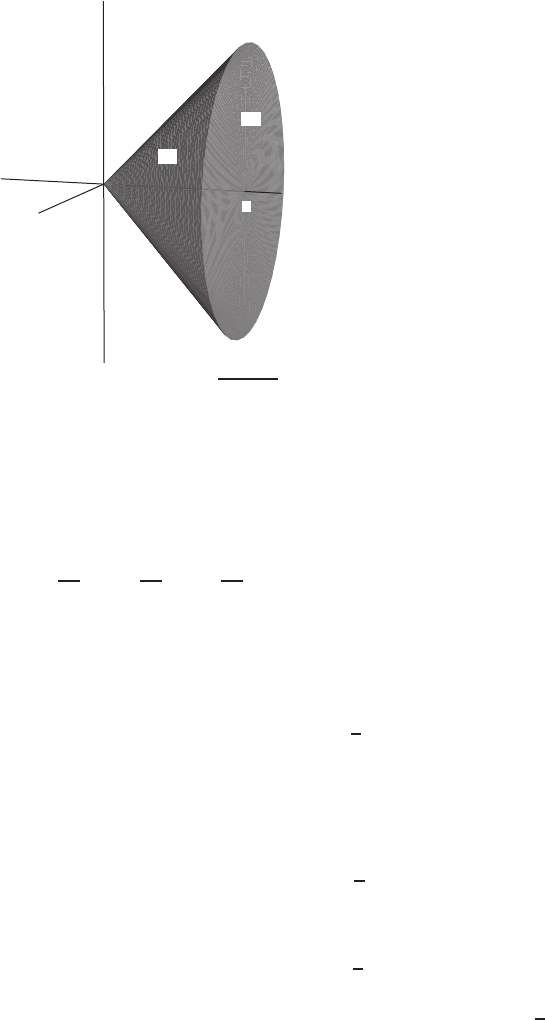
1788 Chapter Nineteen /SOLUTIONS
x
z
2
S2
S1
Figure 19.27
: The cone x=py2+z2for
0≤x≤2
(b) (i) On S2, we have d~
A=~
i dA, so only the~
icomponent of ~
Fcontributes to the flux through S2. On S2, we have
x= 2 so ZS2
~
F·d~
A=ZS2
3·2
~
i·~
idA = 6 ·Area of S2= 6(π22) = 24π.
(ii) Since it is difficult to calculate the flux through S1directly, we use the Divergence Theorem, with
div ~
F=∂
∂x (3x) + ∂
∂y (4y) + ∂
∂z (5z) = 3 + 4 + 5 = 12.
Let Wbe the interior of the cone. Then by the Divergence Theorem,
ZS
~
F·d~
A=ZS1
~
F·d~
A+ZS2
~
F·d~
A=ZW
div ~
F dV,
so ZS
~
F·d~
A=ZW
12dV = 12 ·Volume of cone = 12 ·1
3π22·2= 32π.
Thus ZS1
~
F·d~
A=ZW
div ~
F dV −ZS2
~
F·d~
A= 32π−24π= 8π.
56. (a) On the disk, only the~
i-component, 5
~
i, contributes to the integral, so
ZS1
~r ·d~
A=ZS1
5
~
i·~
idA = 5 ·Area of disk = 5π(√7)2= 35π.
(b) Using the Divergence Theorem, with Wthe region within the cylinder and div ~r = 3,
ZS2
~r ·d~
A=ZW
3dV= 3 ·Volume of cylinder = 3 ·π(√7)2·5 = 105π.
(c) The closed cylinder S2has sides consisting of S1and S3, and also a disk, S4, in the yz-plane y2+z2≤√7,x= 0.
Since the~
icomponent is 0on S4, the flux through S4is 0. Thus,
ZS2
~r ·d~
A=ZS1
~r ·d~
A+ZS3
~r ·d~
A+ZS4
~r ·d~
A .
105π= 35π+ZS3
~r ·d~
A+0,
so ZS3
~r ·d~
A= 105π−35π= 70π.
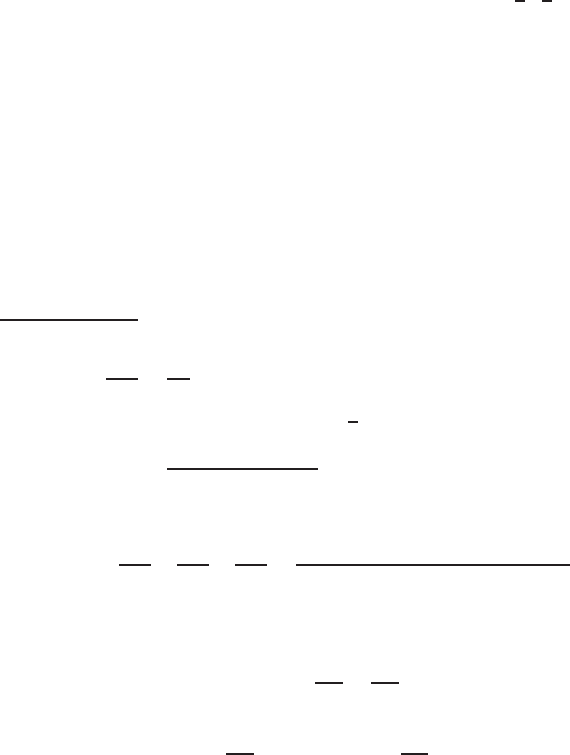
SOLUTIONS to Review Problems for Chapter Nineteen 1789
57. We cannot find ZS
~
F·d~
Adirectly as we do not know f1and f2. We close the surface by adding D, the disk x2+y2≤9
in the xy-plane, oriented upward. If Wis the solid region enclosed, the Divergence Theorem tells us
ZS+D
~
F·d~
A=ZW
div ~
F dV =ZW
5dV = 5 ·Volume of W= 5 ·1
2·4
3π33= 90π.
Thus, ZS
~
F·d~
A+ZD
~
F·d~
A= 90π.
Only the ~
kcomponent of ~
Fcontributes to the flux through D, where d~
A=~
k dA, so
ZD
~
F·d~
A=ZD
~
k·~
kdA =Area of D=π32= 9π.
Thus, ZS
~
F·d~
A=90π−ZD
~
F·d~
A= 90π−9π= 81π.
58. (a) Since ~
F=x
~
i+y~
j+z~
k
(x2+y2+z2)3/2,
∂F1
∂x =∂
∂x x(x2+y2+z2)−3/2
= 1(x2+y2+z2)−3/2−3
2x(x2+y2+z2)−5/2·2x
=x2+y2+z2−3x2
(x2+y2+z2)5/2.
Similar calculations for ∂F2/∂y and ∂F3/∂z show that
div ~
F=∂F1
∂x +∂F2
∂y +∂F3
∂z =3(x2+y2+z2)−3x2−3y2−3z2
(x2+y2+z2)5/2= 0.
Thus div ~
Fis undefined at the origin, but it is zero everywhere else.
(b) The vector field ~
Fis everywhere perpendicular to the surface of the sphere, and on the sphere we have
||~
F|| =10
103=1
102.
Thus ZS
~
F·d~
A=1
102·Area of sphere =1
102·4π102= 4π.
(c) Since div ~
F= 0 throughout B1, by the Divergence Theorem
ZB1
~
F·d~
A=ZInterior of B1
div ~
F dV = 0.
(d) Since div ~
Fis not defined at the origin, we cannot use the Divergence Theorem in the same way as we did in part (c).
However, we can apply the Divergence Theorem to W, the space between B2and S, with B2oriented inward:
ZS
~
F·d~
A+ZB2(inward)
~
F·d~
A=ZW
div ~
F dV = 0,
Thus ZB2(outward)
~
F·d~
A=−ZB2(inward)
~
F·d~
A=ZS
~
F·d~
A= 4π.
(e) If the origin is outside the surface, the flux through the surface is 0, by the Divergence Theorem. If the origin is inside
the surface, then we apply the Divergence Theorem to the region between the surface and a sphere. The sphere is
taken large enough to contain the surface entirely within it, or small enough to lie entirely within the surface. We find
that the flux is 4π. The only case we do not consider is when the origin actually lies on the surface.

1790 Chapter Nineteen /SOLUTIONS
59. We can rewrite ~
Fin terms of (x, y, z)as
~
F=−Gmx
p(x2+y2+z2)3
~
i+−Gmy
p(x2+y2+z2)3
~
j+−Gmz
p(x2+y2+z2)3
~
k
Now we find the divergence of ~
Fin the usual manner
div ~
F=∂
∂x −Gmx
p(x2+y2+z2)3+∂
∂y −Gmy
p(x2+y2+z2)3+∂
∂z −Gmz
p(x2+y2+z2)3
=−3Gm x2+y2+z2
(x2+y2+z2)5/2+3Gm
(x2+y2+z2)3/2
= 0.
Thus, div ~
F= 0 for all points except the origin. We consider a region enclosed by two concentric spheres. Since the
divergence of the field is zero at all points except the origin, the volume enclosed contains only points with zero divergence.
Consequently, the flux through the surface of the enclosed volume must be zero. Since the field is always inward pointing,
this is equivalent to saying that the flux into the outer sphere must equal the flux out of the inner sphere, and so we see
that for any two spheres, the flux must be equal, which shows that the flux is independent of the radius of the spheres.
60. Since the divergence is zero at all points not containing the charge, the flux must be zero through any closed surface
containing no charge. We imagine a surface composed of two concentric cylinders and their end-caps, where the axis of
both cylinders is the z-axis. Then, since no charge is contained in the region enclosed, the flux through the surface must
be zero. Now, we know that the field points away from the axis, which means it is parallel to the end-caps. Consequently,
there must be no flux through the end-caps. This implies that the flux through the inner cylinder must equal the flux out
of the outer cylinder. Since the strength of the field only depends upon the distance from the zaxis, the flux through each
cylinder is a constant. This implies that the following equation must hold
Flux through each cylinder =Ea2πraL=Eb2πrbL
where Eaand Ebare the strengths of the field at raand rbrespectively, and Lis the length of the cylinders. Dividing
through, we can arrive at the following relationship:
Ea/Eb=rb/ra
If we take Ebto be a constant at a fixed value of rb, then the equation can be simplified to
Ea=k/ra
where k=Ebrb. Thus we see that the strength of the field is proportional to 1/r.
61. (a) If we examine the equation for ~v , we see that when r= 0, that is, at the center of the pipe, ~v (0) becomes u
~
i . So uis
the speed at the center of the pipe; it is also the maximum speed since u(1 −r2/a2)reaches its maximum at r= 0.
(b) The flow rate at the wall of the pipe (where r=a) is
~v (a) = u(1 −a2/a2)
~
i=~
0.
(c) To find the flux through a circular cross-sectional area, we use polar coordinates in the plane perpendicular to the
velocity. In these coordinates, an infinitesimal area, d~
Abecomes r dr dθ
~
i. So the flux is given by
Flux =ZS
~
v·d~
A=ZS
u(1 −r2/a2)
~
i·r dr dθ
~
i=Z2π
0Za
0
u(1 −r2/a2)r dr dθ
= 2πu Za
0
(r−r3
a2)dr = 2πu a2
2−a2
4=πua2
2.
62. (a) (i) The integral RWρ dV represents the total charge in the volume W.
(ii) The integral RS~
J·d~
Arepresents the total current flowing out of the surface S.
(b) The total current flowing out of the surface Sis the rate at which the total charge inside the surface S(i.e., in the
volume W) is decreasing. In other words,
Rate current flowing out of S=−∂
∂t(charge in W),
so ZS
~
J·d~
A=−∂
∂t ZW
ρ dV .
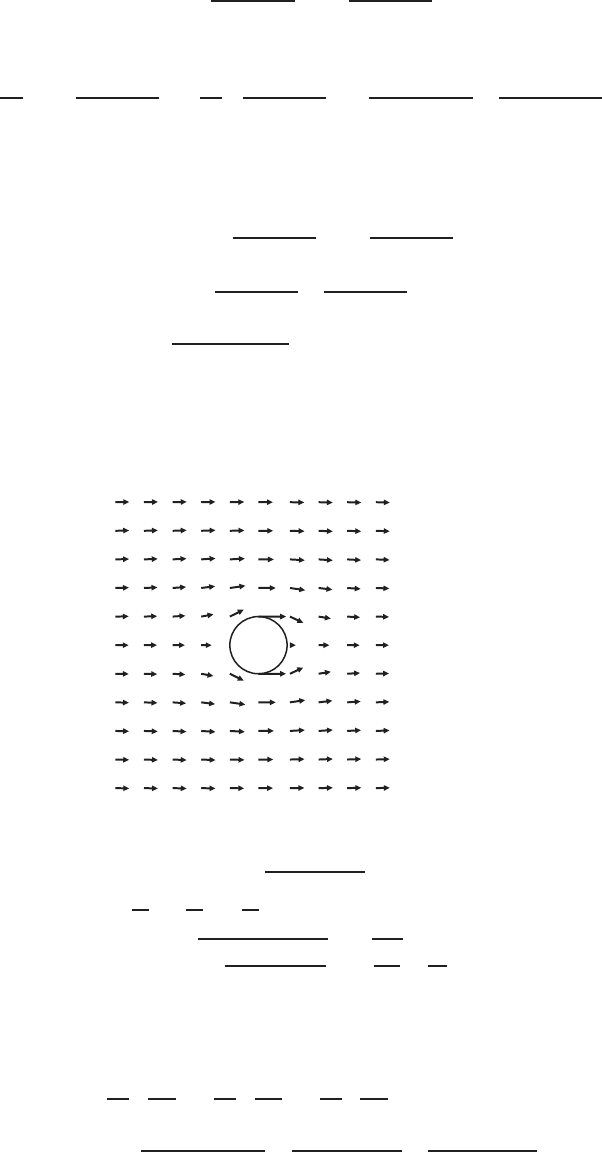
SOLUTIONS to Review Problems for Chapter Nineteen 1791
63. (a) Since ~v = grad φwe have
~v =1 + y2−x2
(x2+y2)2~
i+−2xy
(x2+y2)2~
j
(b) Differentiating the components of ~v , we have
div ~v =∂
∂x 1 + y2−x2
(x2+y2)2+∂
∂y −2xy
(x2+y2)2=2x(x2−3y2)
(x2+y2)3+2x(3y2−x2)
(x2+y2)3= 0
(c) The vector ~v is tangent to the circle x2+y2= 1, if and only if the dot product of the field on the circle with any radius
vector of that circle is zero. Let (x, y)be a point on the circle. We want to show: ~v ·~r =~v (x, y)·(x
~
i+y~
j) = 0.
We have:
~v (x, y)·(x
~
i+y~
j) = 1 + y2−x2
(x2+y2)2~
i+−2xy
(x2+y2)2~
j·(x
~
i+y~
j)
=x+xy2−x2
(x2+y2)2−2xy2
(x2+y2)2
=x(x2+y2−1)
x2+y2,
but we know that for any point on the circle, x2+y2= 1, thus we have ~v ·~r = 0. Therefore, the velocity field is
tangent to the circle. Consequently, there is no flow through the circle and any water on the outside of the circle must
flow around it.
(d) See Figure 19.28.
Figure 19.28
64. (a) The distance from any point to the origin is given by px2+y2+z2, so the denominator is simply r3. The field can
then be rewritten in components as (kx
r3~
i+ky
r3~
j+kz
r3~
k). Its magnitude is thus:
k~v k=rK2x2+y2+z2
r6=rK2
r4=K
r2
which is only a function of the distance from the origin. It is clear that the vector field points away from the origin for
all points (x, y, z), because it is the radius vector x
~
i+y~
j+z~
k, multiplied by the positive scalar K/r3. Suppose
(x, y, z)6= (0,0,0), then
div ~v (x, y, z) = ∂
∂x Kx
r3+∂
∂y Ky
r3+∂
∂z Kz
r3
=K−2x2+y2+z2
r5+x2−2y2+z2
r5+x2+y2−2z2
r5= 0.
Hence, indeed ~v is a point source at the origin.
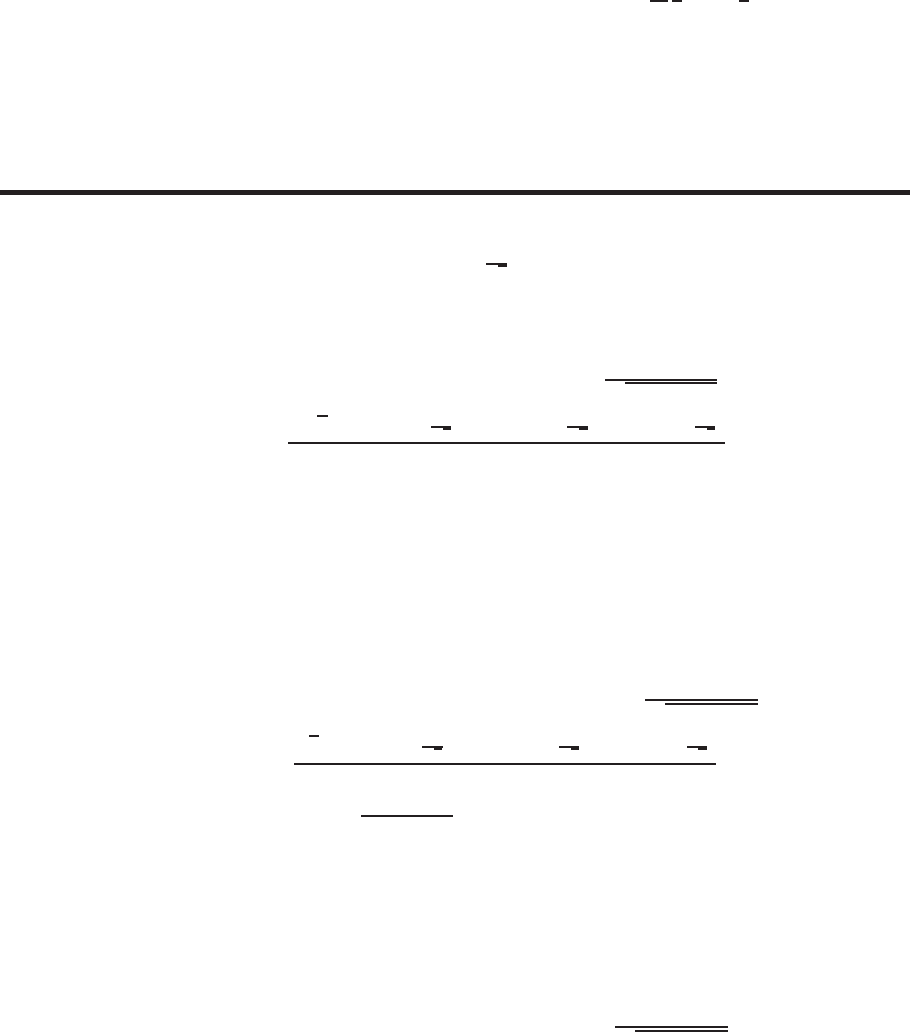
1792 Chapter Nineteen /SOLUTIONS
(b) The dependence of ~v on r, the distance from the origin, is shown in part (a).
(c) The flux through a sphere centered at the origin is calculated as:
Flux = ZS
~
v·d~
A
Since the vector field’s magnitude is a function only of the distance from the origin, it will be constant over the
surface of a sphere centered at the origin. Furthermore, since it is pointed away from the origin, ~v ·d~
Awill be
simply k~v k · kd~
Ak. Thus
Total flux out of a sphere of radius r=k~v rk · k ~
Aspherek=K
r2
4
3πr2=4
3πK.
So the flux does not even depend upon rsince the rate at which the area of the sphere is increasing is exactly equal
to the rate at which the magnitude of the field is decreasing.
(d) This is best handled by observing (as in part (a)) that the divergence of the vector field at any point besides the origin
is zero. Since the divergence anywhere but the origin is zero, the net flux through any closed surface not enclosing
the origin must also be zero.
CAS Challenge Problems
65. (a) When x > 0, the vector x
~
ipoints in the positive x-direction, and when x < 0it points in the negative x-direction.
Thus it always points from the inside of the ellipsoid to the outside, so we expect the flux integral to be positive. The
upper half of the ellipsoid is the graph of z=f(x, y) = 1
√2(1 −x2−y2), so the flux integral is
ZS
~
F·d~
A=Z1/2
−1/2Z1/2
−1/2
x
~
i·(−fx
~
i−fy~
j+~
k)dxdy
=Z1/2
−1/2Z1/2
−1/2
(−xfx)dxdy =Z1/2
−1/2Z1/2
−1/2
x2
p1−x2−y2dxdy
=−√2 + 11 arcsin( 1
√3) + 10 arctan( 1
√2)−8 arctan( 5
√2)
12 = 0.0958.
Different CASs may give the answer in different forms. Note that we could have predicted the integral was positive
without evaluating it, since the integrand is positive everywhere in the region of integration.
(b) For x > −1, the quantity x+ 1 is positive, so the vector field (x+ 1)
~
ialways points in the direction of the positive
x-axis. It is pointing into the ellipsoid when x < 0and out of it when x > 0. However, its magnitude is smaller when
−1/2< x < 0than it is when 0< x < 1/2, so the net flux out of the ellipsoid should be positive. The flux integral
is
ZS
~
F·d~
A=Z1/2
−1/2Z1/2
−1/2
(x+1)
~
i·(−fx
~
i−fy~
j+~
k)dxdy
=Z1/2
−1/2Z1/2
−1/2−(x+1)fxdxdy =Z1/2
−1/2Z1/2
−1/2
x(1 + x)
p1−x2−y2dxdy
=
√2−11 arcsin( 1
√3)−10 arctan( 1
√2) + 8 arctan( 5
√2)
12 = 0.0958
The answer is the same as in part (a). This makes sense because the difference between the integrals in parts (a) and
(b) is the integral of R1/2
−1/2R1/2
−1/2(x/p1−x2−y2)dxdy, which is zero because the integrand is odd with respect
to x.
(c) This integral should be positive for the same reason as in part (a). The vector field y~
jpoints in the positive y-direction
when y > 0and in the negative y-direction when y < 0, thus it always points out of the ellipsoid. Evaluating the
integral we get
ZS
~
F·d~
A=Z1/2
−1/2Z1/2
−1/2
y~
j·(−fx
~
i−fy~
j+~
k)dxdy
=Z1/2
−1/2Z1/2
−1/2
(−yfy)dxdy =Z1/2
−1/2Z1/2
−1/2
y2
p1−x2−y2dxdy
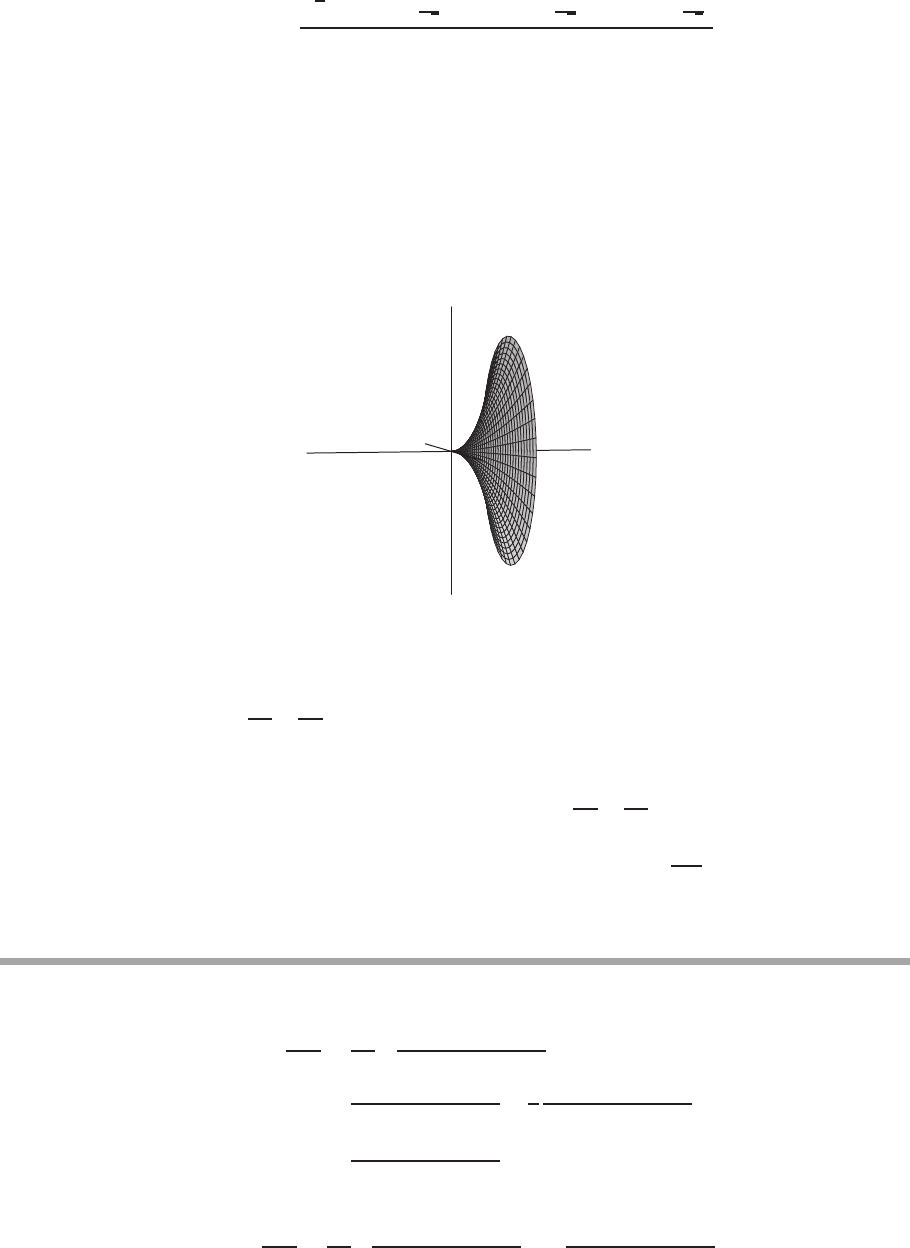
PROJECTS FOR CHAPTER NINETEEN 1793
=
√2−2 arcsin( 1
√3)−19 arctan( 1
√2) + 8 arctan( 5
√2)
12 = 0.0958.
The symbolic answer appears different but has the same numerical value as in parts (a) and (b). In fact the answer is
the same because the integral here is the same as in part (a) except that the roles of xand yhave been exchanged.
Different CASs may give different symbolic forms.
66. (a) The surface has a shape of a flower or trumpet opening in the direction of the positive y-axis. See Figure 19.29.
The outer rim is a circle of radius 4, so the surface lies above z=−4. Thus z+ 4 >0on the surface, so the
vector field (z+ 4)~
kpoints in the positive zdirection everywhere on the surface. Thus it crosses the surface in the
opposite direction as the orientation when it is below the xy-plane, and in the same direction when it is above the
xy-plane. Also, it has smaller magnitude when −2≤z≤2than it does when 0≤z≤2, so we expect the negative
contribution to the flux integral to be smaller than the positive contribution, so the flux integral should be positive.
−x
y
z
Figure 19.29
(b) The area vector element is
∂~r
∂s ×∂~r
∂t =s2cos t
~
i−(2s3cos(t)2+ 2s3sin2t)~
j+s2sin(t)~
k .
This points in the direction of the negative y-axis, as required for computing the flux integral. The flux integral is
ZS
~
F·d~
A=Z2π
0Z2
0
~
F(~
r(s, t)) ·∂~r
∂s ×∂~r
∂t dsdt
=Z2π
0Z2
0
(s2sin t+ 2)s2sin t dsdt =32π
5
PROJECTS FOR CHAPTER NINETEEN
1. (a) Taking partial derivatives using the product rule, we have
∂F1
∂x =∂
∂x x
(x2+y2+z2)3/2
=1
(x2+y2+z2)3/2−3
2
x·2x
(x2+y2+z2)5/2
=y2+z2−2x2
(x2+y2+z2)5/2.
Similarly,
∂F2
∂y =∂
∂y y
(x2+y2+z2)3/2=x2+z2−2y2
(x2+y2+z2)5/2
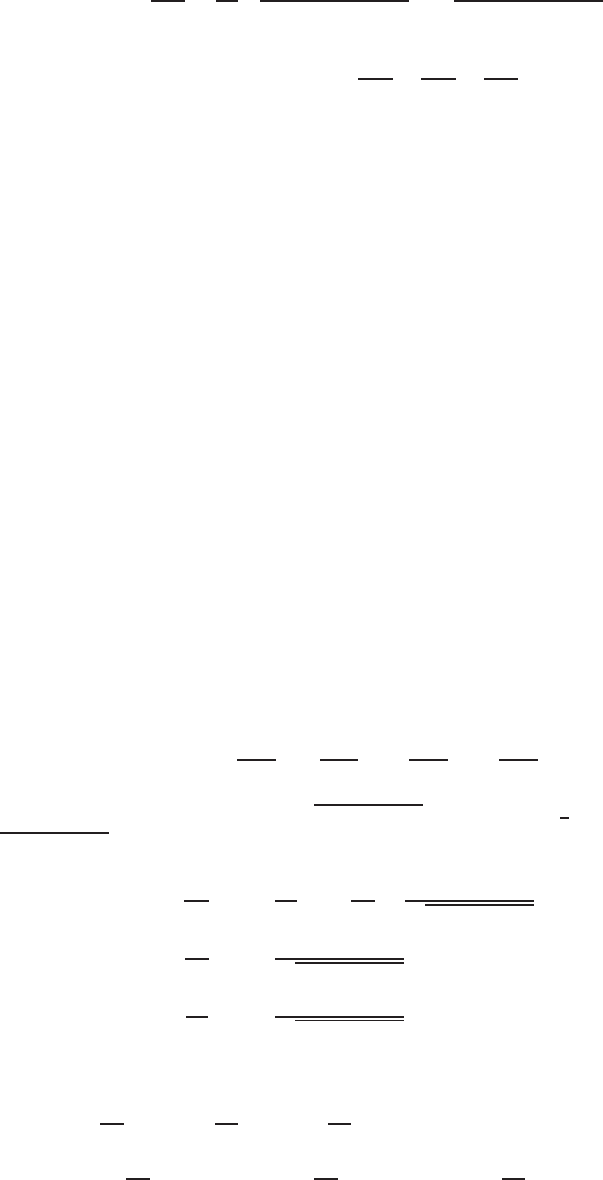
1794 Chapter Nineteen /SOLUTIONS
and ∂F3
∂z =∂
∂z z
(x2+y2+z2)3/2=x2+y2−2z2
(x2+y2+z2)5/2.
Thus,
divergence of ~
F=∂F1
∂x +∂F2
∂y +∂F3
∂z = 0.
(b) Let Sbe the closed surface, oriented outward, consisting of three pieces
•S1
• −S2
•S3, the surface connecting the boundaries of S1and S2, consisting of line segments on lines through
the origin.
By the Divergence Theorem and part (a),
ZS
~
F·d~
A=0.
Hence ZS1
~
F·d~
A−ZS2
~
F·d~
A+ZS3
~
F·d~
A= 0.
The key observation is that the vector field ~
Fis tangent to the lateral surface S3. Therefore, RS3
~
F·
d~
A=0and it follows that ZS1
~
F·d~
A=ZS2
~
F·d~
A .
(c) Compute the integral over S2, which is on the unit sphere. Notice that ~
Fis perpendicular to the sphere
and that on the sphere, ||~
F|| = 1. Thus
ZS1
~
F·d~
A=ZS2
~
F·d~
A=||~
F|| ·Area of S2=Area ofS2.
2. (a) Since ~e ρis a unit vector pointing radially away from the origin, ~
eρ=~r /k~r k=~r /ρ. Thus, we have
~
F=f(ρ)
ρ~r =f(ρ)
ρx
~
i+f(ρ)
ρy~
j+f(ρ)
ρz~
k .
Let g(ρ) = f(ρ)/ρ. Since ρ=k~r k=px2+y2+z2, and ∂ρ/∂x =1
2(x2+y2+z2)−1/2·2x=
x/px2+y2+z2, using the chain rule, we have
∂
∂xg(ρ) = d
dρg(ρ)·∂ρ
∂x =x
px2+y2+z2g′(ρ)
∂
∂y g(ρ) = y
px2+y2+z2g′(ρ)
∂
∂z g(ρ) = z
px2+y2+z2g′(ρ).
So
div ~
F=∂
∂x(g(ρ)x) + ∂
∂y (g(ρ)y) + ∂
∂z (g(ρ)z)
=x∂
∂xg(ρ) + g(ρ)+y∂
∂y g(ρ) + g(ρ)+z∂
∂z g(ρ) + g(ρ)
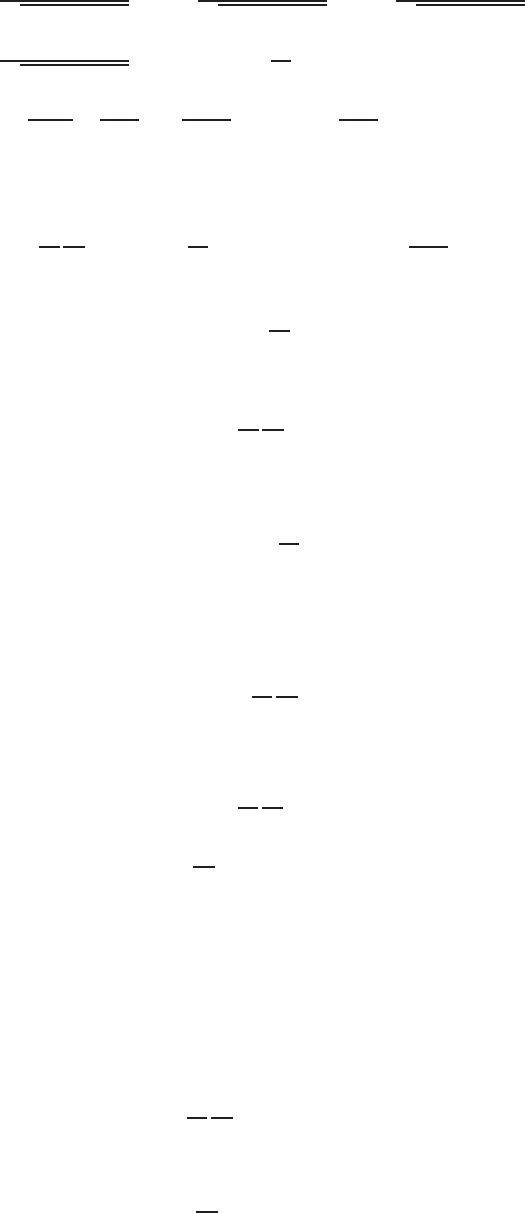
PROJECTS FOR CHAPTER NINETEEN 1795
=x2
px2+y2+z2g′(ρ) + y2
px2+y2+z2g′(ρ) + z2
px2+y2+z2g′(ρ) + 3g(ρ)
=x2+y2+z2
px2+y2+z2g′(ρ) + 3g(ρ) = ρ2
ρg′(ρ) + 3g(ρ) = ρg′(ρ) + 3g(ρ)
=ρf′(ρ)
ρ−f(ρ)
ρ2+3f(ρ)
ρ=f′(ρ) + 2 f(ρ)
ρ.
On the other hand,
1
ρ2
d
dρ(ρ2f(ρ)) = 1
ρ2(2ρf(ρ) + ρ2f′(ρ)) = 2 f(ρ)
ρ+f′(ρ).
Thus,
div ~
F=1
ρ2(ρ2f(p)).
(b) Applying the formula from part (a), we have
div ~
F=1
ρ2
d
dρ(ρ2f(ρ)) = 0.
Since ρ6= 0, multiplying by ρ2gives us (d/dρ)(ρ2f(ρ)) = 0, hence ρ2f(ρ)is a constant, say k. So
f(ρ) = k/ρ2, and hence
~
F=k
ρ2~e ρ.
(c) Suppose the sphere, S, has radius R. Since ~
Fhas constant magnitude on Sand points perpendicularly to
S, we have ~
F·d~
A=f(R)dA, so the flux of ~
Fout of Sis RS~
F·d~
A=RSf(R)dA=f(R)RSdA =
f(R)·Area of S= 4πR2f(R). On the other hand, using spherical coordinates, part (a) tells us that:
div ~
F=1
ρ2
d
dρ ρ2f(ρ),
so if Wis the region enclosed by Sthen
ZW
div ~
FdV =ZR
0Zπ
0Z2π
0
1
ρ2
d
dρ(ρ2f(ρ)) ρ2sin φ dθ dφ dρ
= 4πZR
0
d
dρ ρ2f(ρ)dρ = 4πρ2f(ρ)
R
0
= 4πR2f(R).
The fact that RWdiv ~
F dV equals the flux integral, RS~
F·d~
A, confirms the Divergence Theorem.
(d) Since we are assuming ~
Eis spherically symmetric, we can write
~
E=E(ρ)~e ρ.
By part (a) and Gauss’s Law,
div ~
E=1
ρ2
d
dρ(ρ2E(ρ)) = (δ0ρ≤a
0ρ > a
Suppose ρ≤a. Then, since ρ6= 0,
d
dρ(ρ2E(ρ)) = δ0ρ2.

1796 Chapter Nineteen /SOLUTIONS
Therefore
ρ2E(ρ) = Zδ0ρ2dρ =δ0ρ3
3+C,
and so
E(ρ) = δ0ρ
3+C
ρ2.
Since ~
E, and hence E, is assumed to be continuous, we must have C= 0, so E(ρ) = δ0ρ/3.
Now suppose that ρ > a. Then
d
dρ(ρ2E(ρ)) = 0,
therefore
ρ2E(ρ) = k,
and so
E(ρ) = k
ρ2.
Since Eis assumed to be continuous,
lim
ρ→a+E(ρ) = lim
ρ→a−E(ρ).
Now,
lim
ρ→a+E(ρ)=k
a2
lim
ρ→a−E(ρ)=δ0a
3
so k=δ0a3/3. Thus
E(ρ) =
δ0ρ
3ρ≤a
δ0a3
3ρ > a
3. (a) (i) Since the direction of the electric field is perpendicular to the surface of any cylinder with the wire
as an axis, it is parallel to the surfaces of the two washers. Consequently, there is no flux through the
washers.
(ii) Gauss’s Law tells us that the total flux through the surface must be zero, since no charge is contained
within it. (Note that the region within the surface Slies between the cylinders.) Since the flux through
the washers is zero, the flux into the inner surface must equal the flux out of the outer surface in order
for the net flux through the surface to be zero.
(iii) Since the surface area of a cylinder is given by A= 2πRL where Ris the radius of the cylinder and
Lis its length, and we know that EaAa=EbAb(since the fluxes are equal), we have
Eb(2πbL) = Ea(2πaL)
Eb
Ea
=2πaL
2πbL
Eb
Ea
=a
b.
(iv) The equations in part (iii) imply that
aEa=bEb.
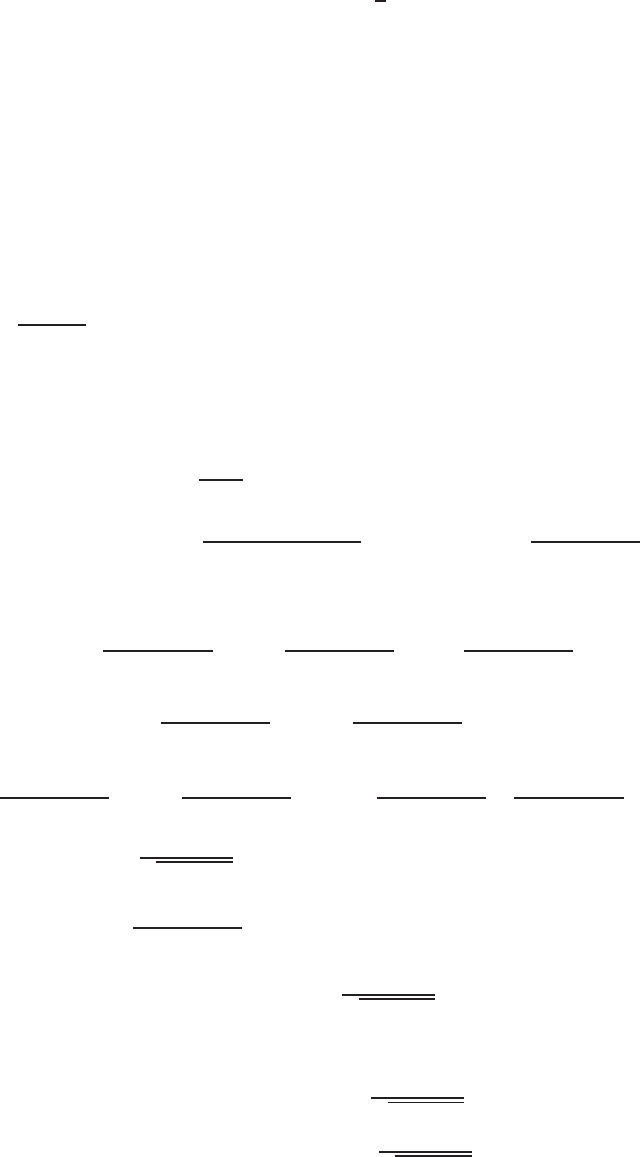
PROJECTS FOR CHAPTER NINETEEN 1797
Since a,bare arbitrary radii we can say:
rEr=Constant
Er=Constant 1
r,
for any radius r. This statement tells us that the strength of the electric field at ris proportional to
1/r.
(b) Since the electric field points perpendicular to the sheet, it is parallel to all sides of the box, except for the
two sides parallel to the sheet. Additionally, since there is no charge contained in the box, Gauss’s Law
tells us the net flux through the surface of the box must be zero. This implies that the flux into the near
face must equal the flux out of the far face. Since the faces have the same area, the field must have equal
strengths at the two faces in order for their fluxes to be equal. Since we did not use the values of aor b, we
see that for all points in space on the same side of the sheet, the field has the same magnitude.
4. (a) (i) In cylindrical coordinates, the position vector of a point (R, θ, z)on the cylinder is given by
~r =Rcos θ
~
i+Rsin θ~
j+z~
k .
So k~r k=√R2+z2. For an area element on the cylinder we have
d~
A= (cos θ
~
i+ sin θ~
j)R dz dθ,
so the flux integral is:
ZS
~
E·d~
A=Z2π
0ZH
−H
q~
r
k~r k3·(cos θ
~
i+ sin θ~
j)R dz dθ
=qZ2π
0ZH
−H
Rcos2θ+Rsin2θ
(R2+z2)3/2R dz dθ = 2πq ZH
−H
R2dz
(R2+z2)3/2.
To compute this one variable integral, we write:
ZH
−H
R2dz
(R2+z2)3/2=ZH
−H
(R2+z2)dz
(R2+z2)3/2−ZH
−H
z2dz
(R2+z2)3/2
We calculate the integral ZH
−H
z2dz
(R2+z2)3/2=ZH
−H
zzdz
(R2+z2)3/2using integration by parts:
ZH
−H
z2dz
(R2+z2)3/2=ZH
−H
dz
(R2+z2)1/2− ZH
−H
dz
(R2+z2)1/2−z
(R2+z2)1/2
H
−H!
=2H
√R2+H2.
Note that the integral ZH
−H
dz
(R2+z2)1/2has canceled. Therefore we have
ZS
~
E·d~
A= 4πq H
√R2+H2.
(ii) •Let Rbe fixed. We have
lim
H→0ZS
~
E·d~
A=lim
H→04πq H
√H2+R2= 0.
lim
H→∞ ZS
~
E·d~
A= lim
H→∞ 4πq H
√H2+R2= 4πq.
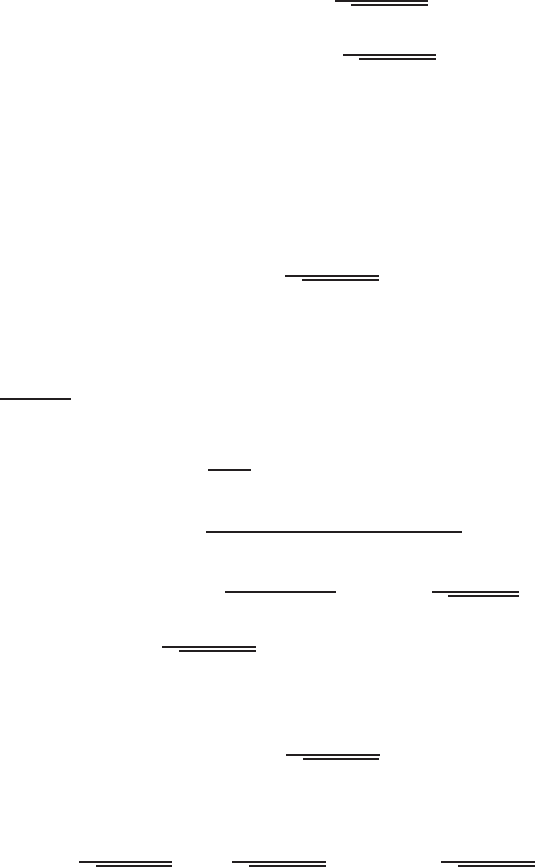
1798 Chapter Nineteen /SOLUTIONS
•Now let Hbe fixed. We have
lim
R→0ZS
~
E·d~
A= lim
R→04πq H
√H2+R2= 4πq.
lim
R→∞ZS
~
E·d~
A= lim
R→∞
4πq H
√H2+R2= 0.
Each of these results is as we would expect from Gauss’s Law.
(b) Let Sdenote the side of the cylinder. We have
ZT
~
E·d~
A=ZS
~
E·d~
A+ZTop
~
E·d~
A+ZBottom
~
E·d~
A.
The result of part (a) shows that ZS
~
E·d~
A= 4πq H
√R2+H2.
Let’s compute RTop ~
E·d~
A.The normal at any point on the top is ~n =~
kand so d~
A=~
k r drdθ. On the
top, z=Hso
~r =rcos θ
~
i+rsin θ~
j+H~
k .
Therefore k~r k=√r2+H2and we have
ZTop
~
E·d~
A=Z2π
0ZR
0
q~
r
k~r k3·~
k r dr dθ
=qZ2π
0ZR
0
(rcos θ
~
i+rsin θ~
j+H~
k)·~
k
(r2+H2)3/2r dr dθ
=qH Z2π
0ZR
0
r dr dθ
(r2+H2)3/2=−2πqH 1
√r2+H2
R
0
=−2πq H
√R2+H2+ 2πq.
Similarly, or using a symmetry argument, we find that the flux through the bottom is given by
ZBottom
~
E·d~
A=−2πqH
√R2+H2+ 2πq.
Thus, the total flux is given by
ZS
~
E·d~
A=4πq H
√R2+H2−2πq H
√R2+H2+ 2πq −2πq H
√R2+H2+ 2πq
= 4πq.
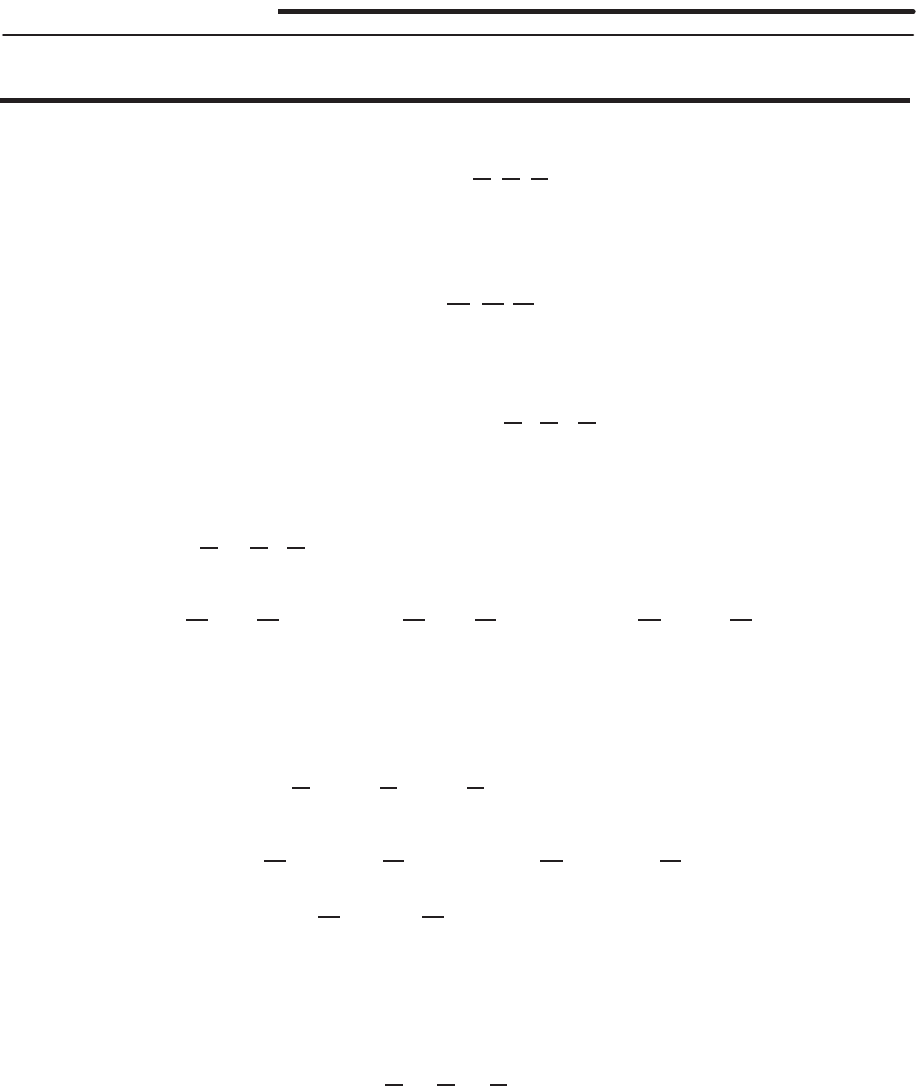
20.1 SOLUTIONS 1799
Job: chap20-sols Sheet: 1 Page: 1799 (August 24, 2012 11 : 19) [ex-1]
CHAPTER TWENTY
Solutions for Section 20.1
Exercises
1. Vector. We have
curl(z~
i−x~
j+y~
k) =
~
i~
j~
k
∂
∂x
∂
∂y
∂
∂z
z−x y
=~
i+~
j−~
k .
2. Vector. We have
curl(−2z~
i−z~
j+xy~
k) =
~
i~
j~
k
∂
∂x
∂
∂y
∂
∂z
−2z−z xy
= (x+ 1)
~
i−(y+ 2)~
j .
3. We have
curl(3x
~
i−5z~
j+y~
k) =
~
i~
j~
k
∂
∂x
∂
∂y
∂
∂z
3x−5z y
= 6
~
i .
4. Using the definition in Cartesian coordinates, we have
curl ~
F=
~
i~
j~
k
∂
∂x
∂
∂y
∂
∂z
x2−y22xy 0
=∂
∂y (0) −∂
∂z (2xy)~
i+−∂
∂x (0) + ∂
∂z (x2−y2)~
j+∂
∂x (2xy)−∂
∂y (x2−y2)~
k
= 4y~
k .
5. Using the definition in Cartesian coordinates,
curl ~
F=
~
i~
j~
k
∂
∂x
∂
∂y
∂
∂z
(−x+y) (y+z) (−z+x)
=∂
∂y (−z+x)−∂
∂z (y+z)~
i+−∂
∂x (−z+x) + ∂
∂z (−x+y)~
j
+∂
∂x (y+z)−∂
∂y (−x+y)~
k
=−~
i−~
j−~
k .
6. Using the definition in Cartesian coordinates,
curl ~
F=
~
i~
j~
k
∂
∂x
∂
∂y
∂
∂z
2yz 3xz 7xy
= (7x−3x)
~
i−(7y−2y)~
j+ (3z−2z)~
k
= 4x
~
i−5y~
j+z~
k .
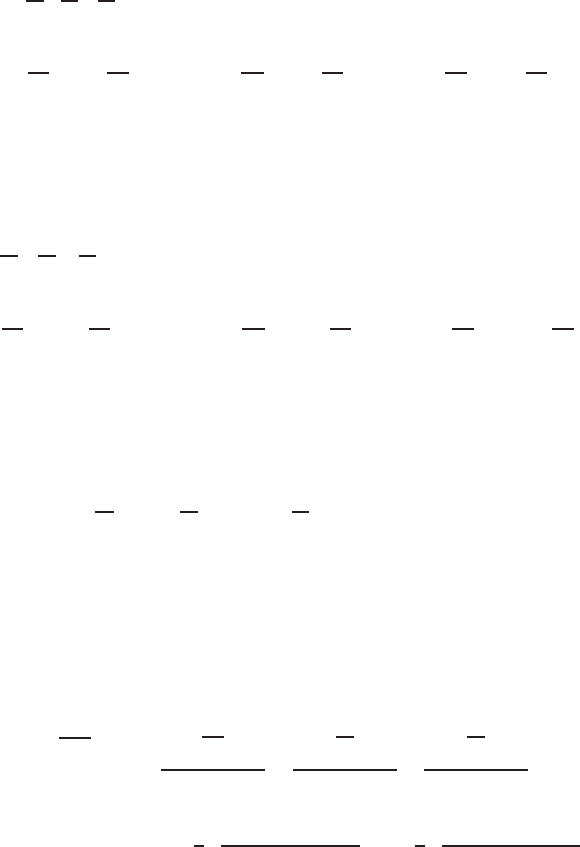
1800 Chapter Twenty /SOLUTIONS
Job: chap20-sols Sheet: 2 Page: 1800 (August 24, 2012 11 : 19) [ex-1]
7. Using the definition in Cartesian coordinates,
curl ~
F=
~
i~
j~
k
∂
∂x
∂
∂y
∂
∂z
x2y3z4
=∂
∂y (z4)−∂
∂z (y3)~
i+−∂
∂x (z4) + ∂
∂z (x2)~
j+∂
∂x (y3)−∂
∂y (x2)~
k
=~
0.
8.Using the definition in Cartesian coordinates,
curl ~
F=
~
i~
j~
k
∂
∂x
∂
∂y
∂
∂z
excos y ez2
=∂
∂y (ez2)−∂
∂z (cos y)~
i+−∂
∂x (ez2) + ∂
∂z (ex)~
j+∂
∂x (cos y)−∂
∂y (ex)~
k
=~
0.
9. Using the definition in Cartesian coordinates
curl ~
F=
~
i~
j~
k
∂
∂x
∂
∂y
∂
∂z
x+yz y2+xzy zx3y2+x7y6
= (2x3yz + 6x7y5−xy)
~
i+ (−3x2y2z−7x6y6+y)~
j+ (yz −z)~
k
10. This vector field points radically outward and has unit length everywhere (except the origin). Thus, we would expect its
curl to be ~
0. Computing the curl directly we get
curl ~r
k~r k=
~
i~
j~
k
∂
∂x
∂
∂y
∂
∂z
x
(x2+y2+z2)1/2
y
(x2+y2+z2)1/2
z
(x2+y2+z2)1/2
The~
i-component is given by =−1
2·2yz
(x2+y2+z2)3/2−−1
2·2yz
(x2+y2+z2)1/2~
i
= 0
Similarly, the ~
jand ~
kcomponents are also both 0.
11. The circulation of the vector field around the boundary of any square centered at the origin with sides parallel to the axes
is positive because the line integrals on the top and bottom sides are positive and the line integrals on the left and right
sides are zero. Therefore, we suspect a nonzero curl.
12. The circulation around any square centered on the origin with sides parallel to the axes is zero because the line integrals
on all four sides are zero, so we suspect a zero curl.
13. The circulation around any rectangle centered on the origin with sides parallel to the axes is zero because the line integrals
on the top and bottom sides add to zero and the line integrals on the left and right sides are zero. We suspect that the vector
field has zero curl.
14. The vector field is swirling counterclockwise, so the circulation around any circle centered at the origin is positive. Thus
we suspect a nonzero curl.
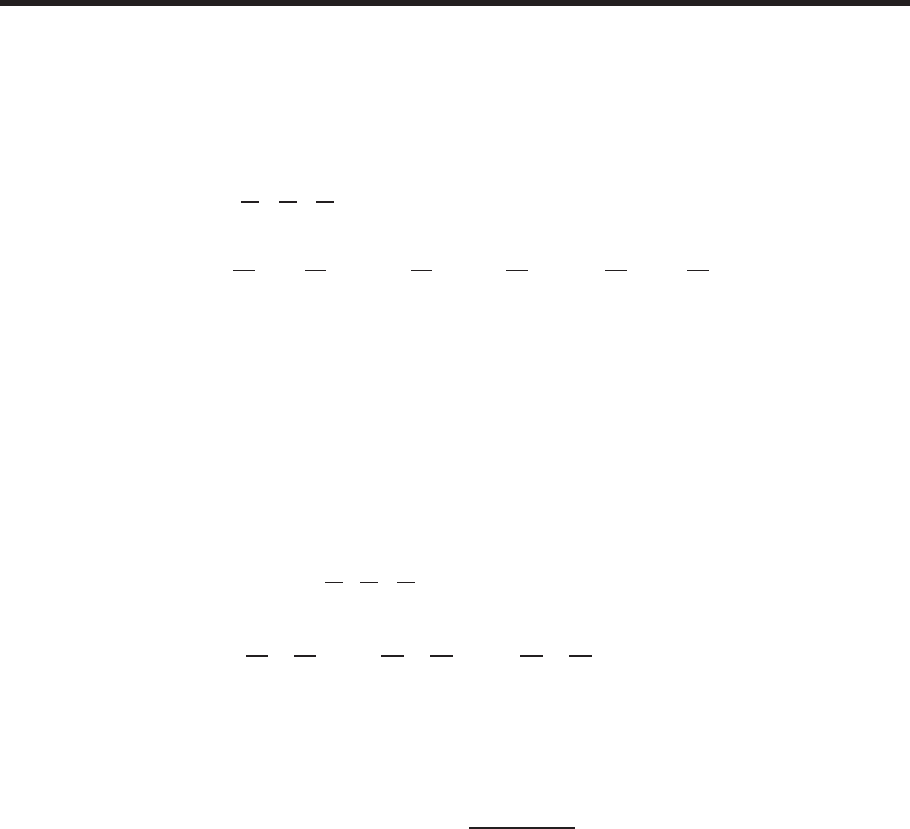
20.1 SOLUTIONS 1801
Job: chap20-sols Sheet: 3 Page: 1801 (August 24, 2012 11 : 19) [ex-1]
Problems
15. (a) The vector field always points perpendicularly to both ~
kand ~r , in the direction determined by the right hand rule,
and its magnitude is twice the magnitude of ~r . Thus
~
F(~r ) = 2~
k×~r =−2y~
i+ 2x~
j .
(b) Using the definition in Cartesian coordinates
curl ~v =
~
i~
j~
k
∂
∂x
∂
∂y
∂
∂z
−2y2x0
= ( ∂
∂y (0) −∂
∂z (2x))
~
i+ ( ∂
∂z (−2y)−∂
∂x (0))~
j+ ( ∂
∂x (2x)−∂
∂y (−2y))~
k= 4~
k .
This makes sense, because we computed the circulation density of this vector field in the z-direction and found it was
4, and we would expect the z-direction to give the maximum circulation density from the symmetry of the vector
field.
16. The part of this vector field in the xy-plane looks like Figure 19.29 on page 1025, and shows no rotational tendency. Thus
we expect the curl to be ~
0. In fact it is, because the circulation around every closed curve Cis zero, since
~
F=x
~
i+y~
j+z~
k= grad(x2/2 + y2/2 + z2/2),
so ~
Fis a gradient field. Thus the circulation density is zero in any direction, and hence curl ~
F(P) = ~
0for every point
P. Using the formula, we see that
curl ~
F=∇ × ~
F=
~
i~
j~
k
∂
∂x
∂
∂y
∂
∂z
x y z
=∂z
∂y −∂y
∂z ~
i+∂x
∂z −∂z
∂x ~
j+∂y
∂x −∂x
∂y ~
k= 0
~
i+ 0~
j+ 0~
k=~
0.
17. The curl is defined in such a way that if ~n is a unit vector and Cis a small circle in the plane perpendicular to ~n and with
orientation induced by ~n , then
(curl ~
G)·~n =Circulation density
≈RC~
G·d~r
Area inside C
so
Circulation =ZC
~
G·d~r ≈(curl ~
G)·~n ·Area inside C.
(a) Let Cbe the circle in the xy-plane, and let ~n =~
k. Then
Circulation ≈(2
~
i−3~
j+ 5~
k)·~
k·π(0.01)2
= 0.0005π.
(b) By a similar argument to part (a), with ~n =~
i, we find the circulation around the circle in the yz-plane:
Circulation ≈(2
~
i−3~
j+ 5~
k)·~
i·π(0.01)2
= 0.0002π.
(c) Similarly for circulations around the circle in the xz-plane,
Circulation ≈ −0.0003π.
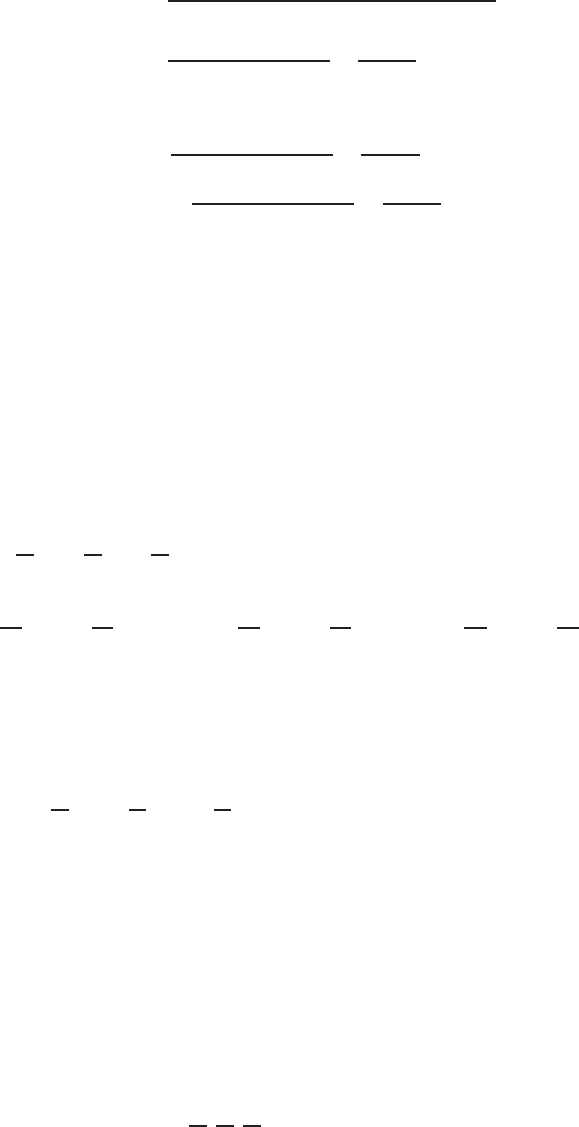
1802 Chapter Twenty /SOLUTIONS
Job: chap20-sols Sheet: 4 Page: 1802 (August 24, 2012 11 : 19) [ex-1]
18. The vector curl ~
Fhas its component in the x-direction given by
(curl ~
F)x≈Circulation around small circle around x-axis
Area inside circle
=Circulation around C2
Area inside C2
=0.5π
π(0.1)2= 50.
Similar reasoning leads to
(curl ~
F)y≈Circulation around C3
Area inside C3
=3π
π(0.1)2= 300,
(curl ~
F)z≈Circulation around C1
Area inside C1
=0.02π
π(0.1)2= 2.
Thus,
curl ~
F≈50
~
i+ 300~
j+ 2~
k .
19. The conjecture is that when the first component of ~
Fdepends only on x, the second component depends only on y, and
the third component depends only on z, that is, if
~
F=F1(x)
~
i+F2(y)~
j+F3(z)~
k
then
curl ~
F=~
0
The reason for this is that if ~
F=F1(x)
~
i+F2(y)~
j+F3(z)~
k, then
curl ~
F=
~
i~
j~
k
∂
∂x
∂
∂y
∂
∂z
F1(x)F2(y)F3(z)
=∂
∂y F3(z)−∂
∂z F2(y)~
i+−∂
∂x F3(z) + ∂
∂z F1(x)~
j+∂
∂x F2(y)−∂
∂y F1(x)~
k
=~
0.
20. (a) We have
curl ~
G=
~
i~
j~
k
∂
∂x
∂
∂y
∂
∂z
ay3+bezcz +dx2esin x+fy
= (f−c)
~
i+ (bez−ecos x)~
j+ (2dx −3ay2)~
k .
(b) If curl ~
Gis parallel to the yz-plane, then it has no~
icomponent. Thus, f−c= 0 or f=c.
(c) If curl ~
Gis parallel to the z-axis, then there are no~
iand ~
jcomponents. Thus,
f−c= 0 and bez−ecos x= 0.
Since the second equation holds for all zand x, we have b=e= 0 as well as f=c.
21. (a) A thin twig at the origin along the x-axis would only feel the velocity along that axis, and thus go counterclockwise.
(b) Clockwise.
(c) Using the Cartesian coordinate definition, we get
curl ~
F=
~
i~
j~
k
∂
∂x
∂
∂y
∂
∂z
y x 0
= 0
~
i+ 0~
j+ (1 −1)~
k=~
0.
This is as expected, since a paddle-wheel (instead of a twig) placed in the field would not rotate at all.
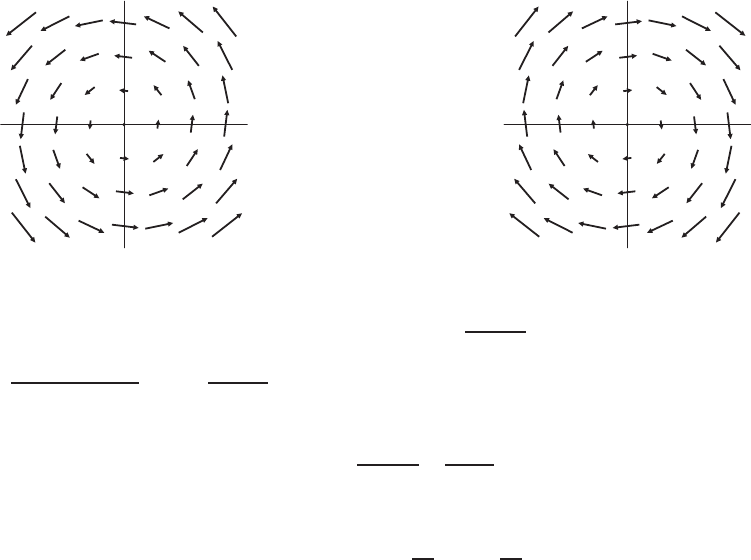
20.1 SOLUTIONS 1803
Job: chap20-sols Sheet: 5 Page: 1803 (August 24, 2012 11 : 19) [ex-1]
22. We have
~
F(t, x, y, z) = (cos t~
j+ sin t~
k)×~r = (zcos t−ysin t)
~
i+xsin t~
j−xcos t~
k ,
so
(curl ~
F)(t, x, y, z) = 2 cos t~
j+ 2 sin t~
k .
(a) At t= 0 the vector (curl ~
F)(0, x, y, z) = 2~
jis horizontal, pointing in the ydirection.
(b) At t=π/2the vector (curl ~
F)(π/2, x, y, z) = 2~
kis vertical, pointing in the zdirection.
(c) At 0<t<π/2the vector (curl ~
F)(t, x, y, z) = 2 cos t~
j+ 2 sin t~
kis parallel to the yz-plane, making an angle of
tradians with the horizontal plane. Thus as tgoes from 0to π/2, the curl goes steadily from horizontal to vertical.
23. Investigate the velocity vector field of the atmosphere near the fire. If the curl of this vector field is non-zero, there is
circulatory motion. Consequently, if the magnitude of the curl of this vector field is large near the fire, a fire storm has
probably developed.
24. (a) Figure 20.1 shows a cross-section of the vector field in xy-plane with ω= 1,so ~v =−y~
i+x~
j .
Figure 20.2 shows a cross-section of vector field in xy-plane with ω=−1, so ~v =y~
i−x~
j .
y
x
Figure 20.1
:~v =−y~
i+x~
j
y
x
Figure 20.2
:~v =y~
i−x~
j
(b) The distance from the center of the vortex is given by r=px2+y2. The velocity of the vortex at any point
is −ωy~
i+ωx~
j, and the speed of the vortex at any point is the magnitude of the velocity, or s=k~v k=
p(−ωy)2+ (ωx)2=|ω|px2+y2=|ω|r.
(c) The divergence of the velocity field is given by:
div ~v =∂(−ωy)
∂x +∂(ωx)
∂y = 0
The curl of the field is:
curl ~v = curl(−ωy~
i+ωx~
j) = ∂
∂x (ωx)−∂
∂y (−ωy)~
k= 2ω~
k
(d) We know that ~v has constant magnitude |ω|Reverywhere on the circle and is everywhere tangential to the circle.
In addition, if ω > 0, the vector field rotates counterclockwise; if ω < 0, the vector field rotates clockwise. Thus if
ω > 0,~v and ∆~r are parallel and in the same direction, so
ZC
~
v·~
dr =|~v | · (Length of C) = ωR ·2πR = 2πωR2
If ω < 0, then |ω|=−ωand ~v and ∆~r are in opposite directions, so
ZC
~v ·~
dr =−|~v | · (Length of C) = −|ω|R·(2πR) = 2πωR2.
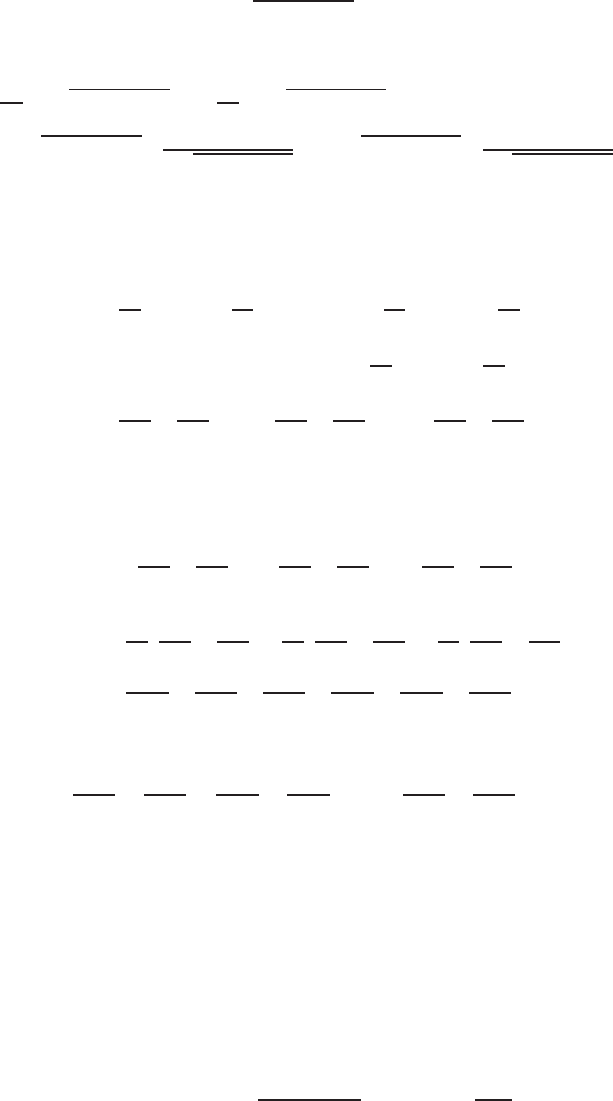
1804 Chapter Twenty /SOLUTIONS
Job: chap20-sols Sheet: 6 Page: 1804 (August 24, 2012 11 : 19) [ex-1]
25. To show that the force field is irrotational we must show that its curl is zero. Let us do this in Cartesian coordinates:
~
F=f(r)~r =f(px2+y2+z2)(x
~
i+y~
j+z~
k)
The third component of curl ~
Fis
∂
∂x (f(px2+y2+z2)y)−∂
∂y (f(px2+y2+z2)x)
=f′(px2+y2+z2)·2xy
2px2+y2+z2−f′(px2+y2+z2)·2xy
2px2+y2+z2
= 0.
A similar computation shows that the other components of curl ~
Fare 0 too.
26. Let ~
C=a
~
i+b~
j+c~
k. Then
curl( ~
F+~
C) = ∂
∂y (F3+c)−∂
∂z (F2+b)~
i+∂
∂z (F1+a)−∂
∂x (F3+c)~
j
+∂
∂x (F2+b)−∂
∂y (F1+a)~
k
=∂F3
∂y −∂F2
∂z ~
i+∂F1
∂z −∂F3
∂x ~
j+∂F2
∂x −∂F1
∂y ~
k
= curl ~
F .
27.
curl ~
F= ( ∂F3
∂y −∂F2
∂z )
~
i+ ( ∂F1
∂z −∂F3
∂x )~
j+ ( ∂F2
∂x −∂F1
∂y ~
k)
div curl ~
F=∂
∂x (∂F3
∂y −∂F2
∂z ) + ∂
∂y (∂F1
∂z −∂F3
∂x ) + ∂
∂z (∂F2
∂x −∂F1
∂y )
=∂2F3
∂x∂y −∂2F2
∂x∂z +∂2F1
∂y∂z −∂2F3
∂y∂x +∂2F2
∂z∂x −∂2F1
∂z∂y
Since, if ~
Fhas continuous second partial derivatives,
∂2F3
∂x∂y =∂2F3
∂y∂x ,∂2F2
∂x∂z =∂2F2
∂z∂x ,and ∂2F1
∂y∂z =∂2F1
∂z∂y
everything cancels out and we get div curl ~
F= 0.
28. The Fundamental Theorem of Calculus for Line Integrals states that if Cis a path from Pto Q, then
ZC
grad f·d~r =f(Q)−f(P).
Since Cis a closed path we have Zc
grad f·d~r =f(P)−f(P) = 0
(a) For any unit vector ~n
circ~n grad f= lim
Area→0Rgrad f·d~r
Area of C = lim
Area→00
Area = 0
where the limit is taken over curves Cin a plane perpendicular to ~n , and oriented by the right hand rule. Thus the
circulation density of grad fis zero in every direction, and hence curl grad f=~
0.
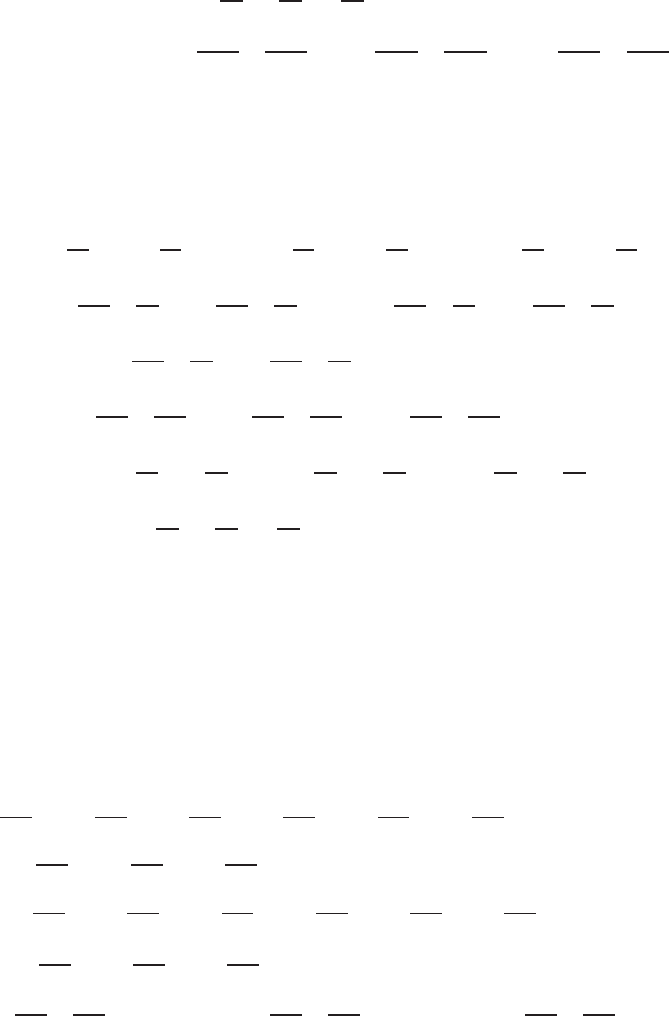
20.1 SOLUTIONS 1805
Job: chap20-sols Sheet: 7 Page: 1805 (August 24, 2012 11 : 19) [ex-1]
(b) Using the Cartesian coordinate definition
curl grad f= curl( ∂f
∂x~
i+∂f
∂y~
j+∂f
∂z ~
k)
=∂2f
∂y∂z −∂2f
∂z∂y ~
i+∂2f
∂z∂x −∂2f
∂x∂z ~
j+∂2f
∂x∂y −∂2f
∂y∂x ~
k
= 0
~
i+ 0~
j+ 0~
k=~
0.
29.
curl(φ~
F)
=∂
∂y (φF3)−∂
∂z (φF2)~
i+∂
∂z (φF1)−∂
∂x (φF3)~
j+∂
∂x (φF2)−∂
∂y (φF1)~
k
=φ∂F3
∂y +∂φ
∂y F3−φ∂F2
∂z −∂φ
∂z F2~
i+φ∂F1
∂z +∂φ
∂z F1−φ∂F3
∂x −∂φ
∂x F3~
j
+φ∂F2
∂x +∂φ
∂x F2−φ∂F1
∂y −∂φ
∂y F1~
k
=φ∂F3
∂y −∂F2
∂z ~
i+∂F1
∂z −∂F3
∂x ~
j+∂F2
∂x −∂F1
∂y ~
k
+∂φ
∂y F3−∂φ
∂z F2~
i+∂φ
∂z F1−∂φ
∂x F3~
j+∂φ
∂x F2−∂φ
∂y F1~
k
=φcurl ~
F+∂φ
∂x~
i+∂φ
∂y~
j+∂φ
∂z ~
k×(F1
~
i+F2~
j+F3~
k)
=φcurl ~
F+ (grad φ)×~
F .
30. By Problem 29, curl ~
F= grad f×grad g+fcurl grad g= grad f×grad g, since curl grad g= 0. Since the cross
product of two vectors is perpendicular to both vectors, curl ~
Fis perpendicular to grad g. But ~
Fis a scalar times grad g,
so curl ~
Fis perpendicular to ~
F.
31. If ~
F=F1
~
i+F2~
j+F3~
k,~u =u1
~
i+u2~
j+u3~
k,~v =v1
~
i+v2~
j+v3~
k, then
grad( ~
F·~v )·~u −grad( ~
F·~u )·~v
= grad(F1v1+F2v2+F3v3)·(u1
~
i+u2~
j+u3~
k)−grad(F1u1+F2u2+F3u3)·(v1
~
i+v2~
j+v3~
k)
=∂F1
∂x v1u1+∂F2
∂x v2u1+∂F3
∂x v3u1+∂F1
∂y v1u2+∂F2
∂y v2u2+∂F3
∂y v3u2+
∂F1
∂z v1u3+∂F2
∂z v2u3+∂F3
∂z v3u3−
∂F1
∂x u1v1+∂F2
∂x u2v1+∂F3
∂x u3v1+∂F1
∂y u1v2+∂F2
∂y u2v2+∂F3
∂y u3v2+
∂F1
∂z u1v3+∂F2
∂z u2v3+∂F3
∂z u3v3
=∂F3
∂y −∂F2
∂z (u2v3−u3v2) + ∂F1
∂z −∂F3
∂x (u3v1−u1v3) + ∂F2
∂x −∂F1
∂y (u1v2−u2v1)
= (curl ~
F)·~u ×~v .
32. (a) Since ~
Fis in the xy-plane, curl ~
Fis parallel to ~
k(because F3= 0 and F1, F2have no z-dependence). Imagine
computing the circulation of ~
Fcounterclockwise around a small rectangle Rat the point Pwith sides of length h
parallel to ~
Fand sides of length tperpendicular to ~
Fas shown in Figure 20.3. Since ~
Fis perpendicular to C2and
C4, the line integral over these two sides is zero. Assuming that ~
Fis approximately constant on C1and C3, its value
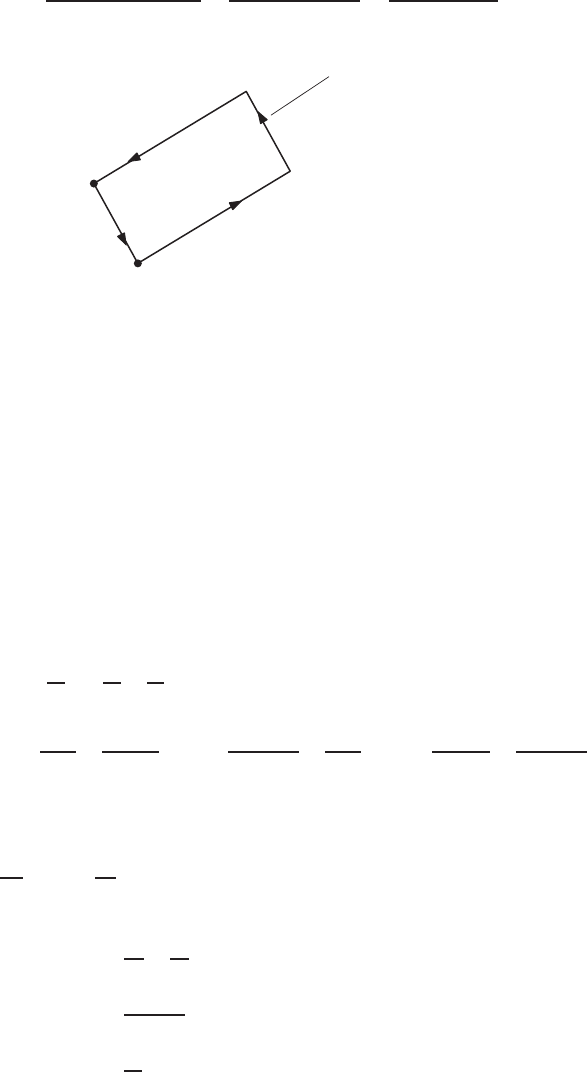
1806 Chapter Twenty /SOLUTIONS
Job: chap20-sols Sheet: 8 Page: 1806 (August 24, 2012 11 : 19) [ex-1]
on these sides is F(Q)~
Tand −F(P)~
T, respectively. Thus, since ~
Fis parallel to C1and C3, the line integral over
C1is approximately F(Q)hand the line integral over C3is approximately −F(P)h. Finally
curl ~
F(P)≈Circulation around R
Area of R≈F(Q)h−F(P)h
ht =F(Q)−F(P)
t
≈Directional derivative of Fin the direction of −−→
P Q.
Q
P
C1
h
h
t
t
C4
C2
C3
✸
~
F
Figure 20.3
: Path Rused to find curl ~
Fat P
(b) Since ~
F=F(x, y)~
T=F(x, y)a
~
i+F(x, y)b~
j, with a, b constant, we have
curl ~
F= (bFx−aFy)~
k .
Also ~
T×~
k= (a
~
i+b~
j)×~
k=b
~
i−a~
j, so
bFx−aFy= (gradF)·(b
~
i−a~
j) = gradF·((a
~
i+b~
j)×~
k) = F~
T×~
k,
where F~
T×~
kis the directional derivative of Fin the direction of the unit vector ~
T×~
k, which is perpendicular to
~
F. The right-hand rule applied to ~
T×~
kshows that ~
T×~
kis obtained by a clockwise rotation of ~
Tthrough 90◦.
33. (a) Using r= (x2+y2)1/2, we calculate rx= (1/2)(x2+y2)−1/22x. Notice that rx=x/r and, by a similar argument,
ry=y/r. We have
curl rA·(−y~
i+x~
j)=
~
i~
j~
k
∂
∂x
∂
∂y
∂
∂z
−rAy rAx0
=∂(0)
∂y −∂(rAx)
∂z ~
i+∂(−rAy)
∂z −∂(0)
∂x ~
j+∂(rAx)
∂x −∂(−rAy)
∂y ~
k
=0
~
i+ 0~
j+c~
k=c~
k
where
c=∂
∂x (xrA)−∂
∂y (−yrA) = rA+AxrA−1rx+rA+AyrA−1ry
= 2rA+ArA−1(xrx+yry)
= 2rA+ArA−1x2
r+y2
r
= 2rA+ArA−1x2+y2
r
= 2rA+ArA−1r2
r
= (2 + A)rA.
(b) The curl is in the direction of ~
kfor A=−1, is the zero vector for A=−2, and is in the direction of −~
kfor
A=−3.
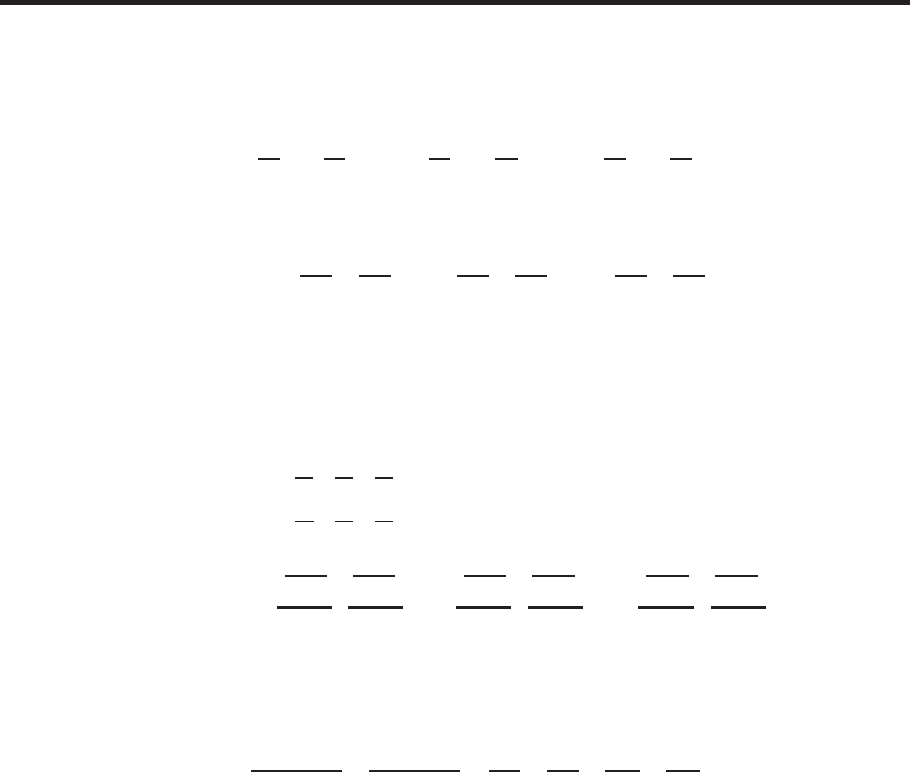
20.1 SOLUTIONS 1807
Job: chap20-sols Sheet: 9 Page: 1807 (August 24, 2012 11 : 19) [ex-1]
The counterclockwise flow in the figure suggests the curl is in the +~
kdirection in all three cases. However, it
is not easy to see all the effects in the picture. The counterclockwise flow indicates that the circulation on any path
around ~
kis positive, but the curl is the circulation density, not the circulation, in the ~
k-direction. To understand the
curl, we must see how the circulation around the ~
k-direction changes when the circles get smaller and smaller. We
need to take into account the changing length of the vector field as well as the changing direction. This is too subtle
an effect to be measured accurately by eye. The three vector fields differ in the rate at which the magnitude of the
vector field changes as you move perpendicular to the flow (the shear) and this accounts for the differing directions
of their curls. When A=−1the magnitude of the vector field is constant, when A=−2or −3the magnitude
decreases as you move farther from the origin, and the decrease is most rapid for A=−3.
(c) The curl has a component only in the ~
kdirection. Think of the this component as the limit of the circulation density
around a small circle in the xy-plane, as the circle shrinks to zero. Thus the sign of the component of the curl tells us
that this circulation around the circle centered at (1,1,1) is positive for A=−1, zero for A=−2, and negative for
A=−3. (This assumes that the circle is small enough that it does not go around the origin, where the vector fields
are not defined.)
Since the vector fields and their curls are not defined at (0,0,0), the curl calculated in part (b) does not tell us
anything about the circulation around a circle centered at (0,0,0).
Strengthen Your Understanding
34. The curl of a vector field is another vector field, not a scalar function.
35. The vector field ~
F=y~
iis parallel to the x-axis at every point, but curl ~
F=−~
k6=~
0.
Though the flow of ~
Fconsists of parallel straight lines, the vector field does exhibit shear, which can produce curl.
36. If ~
F=x2
~
i+y2~
j+z2~
kthen
curl ~
F=∂
∂y z2−∂
∂z y2~
i+∂
∂z x2−∂
∂x z2~
j+∂
∂x y2−∂
∂y x2~
k=~
0.
37. For ~
F=F1
~
i+F2~
j+F3~
k, we have
curl ~
F=∂F3
∂y −∂F2
∂z ~
i+∂F1
∂z −∂F3
∂x ~
j+∂F2
∂x −∂F1
∂y ~
k .
If F1=zand F2=F3= 0, then ~
F=z~
iand curl ~
F=~
j.
38. True. The circulation density is obtained by dividing the circulation around a circle C(a scalar) by the area enclosed by
C(also a scalar), in the limit as the area tends to zero.
39. True.
curl grad f=
~
i~
j~
k
∂
∂x
∂
∂y
∂
∂z
∂f
∂x
∂f
∂y
∂f
∂z
=∂2f
∂y∂z −∂2f
∂z∂y
|{z }
0
~
i+∂2f
∂z∂x −∂2f
∂x∂z
|{z }
0
~
j+∂2f
∂x∂y −∂2f
∂y∂x
|{z }
0
~
k
40. False. As a counterexample, any constant vector field ~
F=a
~
i+b~
j+c~
khas div ~
F= 0 and curl ~
F=~
0.
41. True. Writing ~
F=F1
~
i+F2~
j+F3~
kand ~
G=G1
~
i+G2~
j+G3~
k, we have ~
F+~
G= (F1+G1)
~
i+ (F2+G2)~
j+
(F3+G3)~
k. Then the~
icomponent of curl(~
F+~
G)is
∂(F3+G3)
∂y −∂(F2+G2)
∂z =∂F3
∂y −∂F2
∂z +∂G3
∂y −∂G2
∂z
which is the ~
icomponent of curl ~
Fplus the ~
icomponent of curl ~
G . The ~
jand ~
kcomponents work out in a similar
manner.

1808 Chapter Twenty /SOLUTIONS
Job: chap20-sols Sheet: 10 Page: 1808 (August 24, 2012 11 : 19) [chap20-sols]
42. False. The left-hand side of the equation does not make sense. The quantity (~
F·~
G)is a scalar, so we cannot compute
the curl of it.
43. False. For example, take ~
F=z~
iand ~
G=x~
j . Then ~
F×~
G=xz~
k , and curl(~
F×~
G) = −z~
j . However,
(curl ~
F)×(curl ~
G) = ~
j×~
k=~
i .
44. True. We calculate the x–components for each side of the equation:
(curl(f~
G))1=∂(fG3)
∂y −∂(fG2)
∂z
=∂f
∂y G3+f∂G3
∂y −∂f
∂z G2−f∂G2
∂z
= ( ∂f
∂y G3−∂f
∂z G2) + f(∂G3
∂y −∂G2
∂z )
= ((grad f)×~
G)1+ (f(curl ~
G))1.
Computations for the other two components are similar, so
curl(f~
G) = (grad f)×~
G+f·(curl ~
G).
45. False. For example, take ~
F=z~
i+x~
j . Then curl ~
F=~
j+~
k , which is not perpendicular to ~
F, since (z~
i+x~
j)·(~
j+
~
k) = x6= 0.
46. True. ~
Fis rotating around the yaxis, so by the right hand rule curl ~
Fhas a positive ycomponent. Therefore taking the
dot product of curl ~
Fand ~
jwill give a positive number.
47. (a)
curl(y~
i−x~
j+z~
k) =
~
i~
j~
k
∂
∂x
∂
∂y
∂
∂z
y−x z
=−2~
k
(b)
curl(y~
i+z~
j+x~
k) =
~
i~
j~
k
∂
∂x
∂
∂y
∂
∂z
y z x
=−~
i−~
j−~
k
(c)
curl(−z~
i+y~
j+x~
k) =
~
i~
j~
k
∂
∂x
∂
∂y
∂
∂z
−z y x
=−2~
j
(d)
curl(x
~
i+z~
j−y~
k) =
~
i~
j~
k
∂
∂x
∂
∂y
∂
∂z
x z −y
=−2
~
i
(e)
curl(z~
i+x~
j+y~
k) =
~
i~
j~
k
∂
∂x
∂
∂y
∂
∂z
z x y
=~
i+~
j+~
k
So (a), (c), (d) are parallel to the z-, y-, and x-axes, respectively.
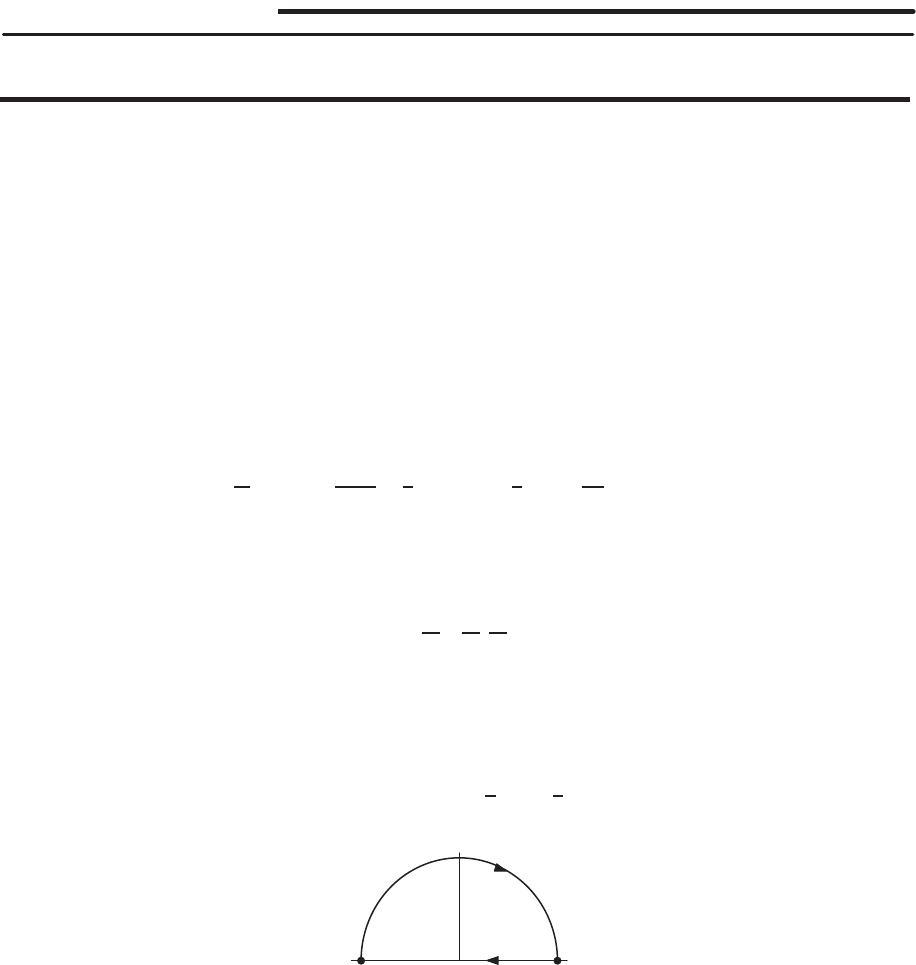
20.2 SOLUTIONS 1809
Job: chap20-sols Sheet: 11 Page: 1809 (August 24, 2012 11 : 19) [ex-2]
Solutions for Section 20.2
Exercises
1. To calculate RC~
F·d~r directly, we compute the integral along the paths C1and C2in Figure 20.4. Now C1is parame-
terized by
x(t) = 3 −t, y(t) = 0 z(t) = 0 for 0≤t≤6,so r′(t) = −~
i ,
and C2is parameterized by
x(t) = −3 cos t, y(t) = 0, z(t) = 3 sin tfor 0≤t≤π, so ~r ′(t) = 3 sin t
~
i+ 3 cos t~
k .
Thus
ZC
~
F·d~r =ZC1
~
F·d~r +ZC2
~
F·d~r
=Z6
0
(3 −t)(
~
i+~
j)·(−~
i)dt +Zπ
0
((−3 cos t+ 3 sin t)
~
i−3 cos t~
j)·(3 sin t
~
i+ 3 cos t~
k)dt
=−Z6
0
(3 −t)dt + 9 Zπ
0
(−sin tcos t+ sin2t)dt
=−3t+t2
2
6
0
+ 9 −sin2t
2−1
2sin tcos t+t
2
π
0
=9π
2.
Formula IV-17 was used to calculate the last integral.
To calculate RC~
F·d~r using Stokes’ Theorem, we find
curl ~
F=
~
i~
j~
k
∂
∂x
∂
∂y
∂
∂z
x+z x y
=~
i+~
j+~
k .
For Stokes’ Theorem, the semicircular region Sin Figure 20.4 is oriented into the page, so d~
A=~
j dx dz. Thus,
ZC
~
F·d~r =ZS
curl ~
F·d~
A=ZS
(
~
i+~
j+~
k)·~
j dx dz =ZS
dx dz
=Area of semicircle =1
2π32=9
2π.
(−3,0,0) (3,0,0)
S
C2
C1
x
z
Figure 20.4
2. Since Cis the curve x2+y2= 4, oriented counterclockwise, we calculate RC~
F·d~r directly using the parameterization
x(t) = 2 cos t, y(t) = 2 sin t, z(t) = 0,0≤t≤2π, so ~r ′(t) = −2 sin t
~
i+ 2 cos t~
j .
Thus,
ZC
~
F·d~r =Z2π
0
(2 sin t
~
i−2 cos t~
j)·(−2 sin t
~
i+ 2 cos t~
j)dt
=−4Z2π
0
(sin2t+ cos2t)dt =−4·2π=−8π.
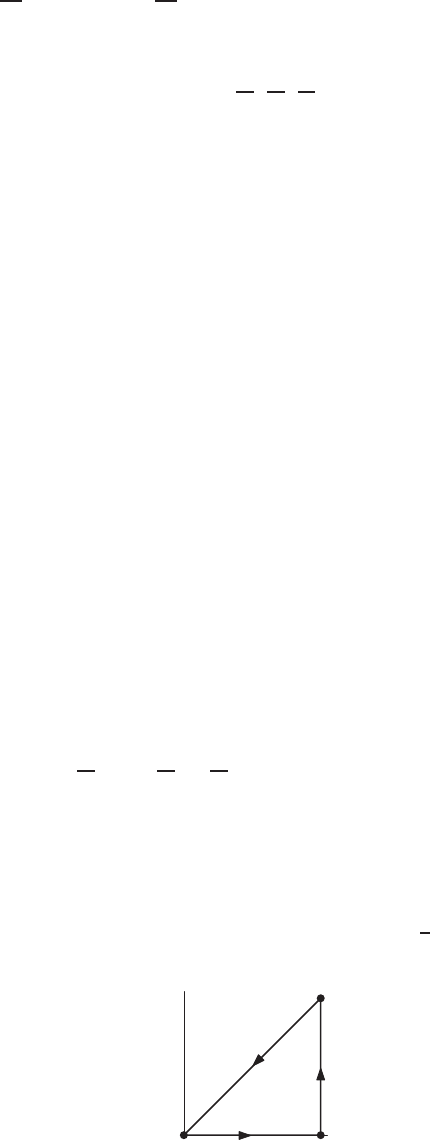
1810 Chapter Twenty /SOLUTIONS
Job: chap20-sols Sheet: 12 Page: 1810 (August 24, 2012 11 : 19) [ex-2]
Since Sis given by z= 4 −x2−y2, we have
∂z
∂x =−2xand ∂z
∂y =−2y, so d~
A= (2x
~
i+ 2y~
j+~
k)dx dy.
Also
curl ~
F=
~
i~
j~
k
∂
∂x
∂
∂y
∂
∂z
y−x0
=−2~
k ,
so, writing Rfor the disk below Sin the xy-plane, Stokes’ Theorem gives
ZC
~
F·d~r =ZS
curl ~
F·d~
A=ZR−2~
k·(2x
~
i+ 2y~
j+~
k)dx dy
=−2Zdx dy =−2·Area of disk =−2·π22=−8π.
3. To calculate RC~
F·d~r directly, we compute the integral along each of the sides C1,C2,C3in Figure 20.5. Now C1is
parameterized by
x(t) = t, y(t) = 0, z(t) = 0 for 0≤t≤5,so r′(t) = ~
i .
Similarly, C2is parameterized by
x(t) = 5, y(t) = t, z(t) = 0 for 0≤t≤5,so ~r ′(t) = ~
j .
Also, C3is parameterized by
x(t) = 5 −t, y(t) = 5 −t, z(t) = 0 for 0≤t≤5,so ~r ′(t) = −~
i−~
j .
Thus
ZC
~
F·d~r =ZC1
~
F·d~r +ZC2
~
F·d~r +ZC3
~
F·d~r
=Z5
0
t(
~
i+~
j)·~
i dt +Z5
0
(5 −t)(
~
i+~
j)·~
j dt +Z5
0
((5 −t)−(5 −t))(
~
i+~
j)·(−~
i−~
j)dt
=Z5
0
t dt +Z5
0
5−t dt +Z5
0
0dt =Z5
0
5dt = 25.
To calculate RC~
F·d~r using Stokes’ Theorem, we find
curl ~
F=
~
i~
j~
k
∂
∂x
∂
∂y
∂
∂z
x−y+z x −y+z0
=−~
i+~
j+ (1 −(−1))~
k=−~
i+~
j+ 2~
k .
For Stokes’ Theorem, the triangular region Sin Figure 20.5 is oriented upward, so d~
A=~
k dx dy. Thus
ZC
~
F·d~r =ZS
curl ~
F·d~
A=ZS
(−~
i+~
j+ 2~
k)·~
k dx dy
=ZS
2dx dy = 2 ·Area of triangle = 2 ·1
2·5·5 = 25.
(5,5,0)
(5,0,0)
(0,0,0)
S
C3C2
C1
x
y
Figure 20.5
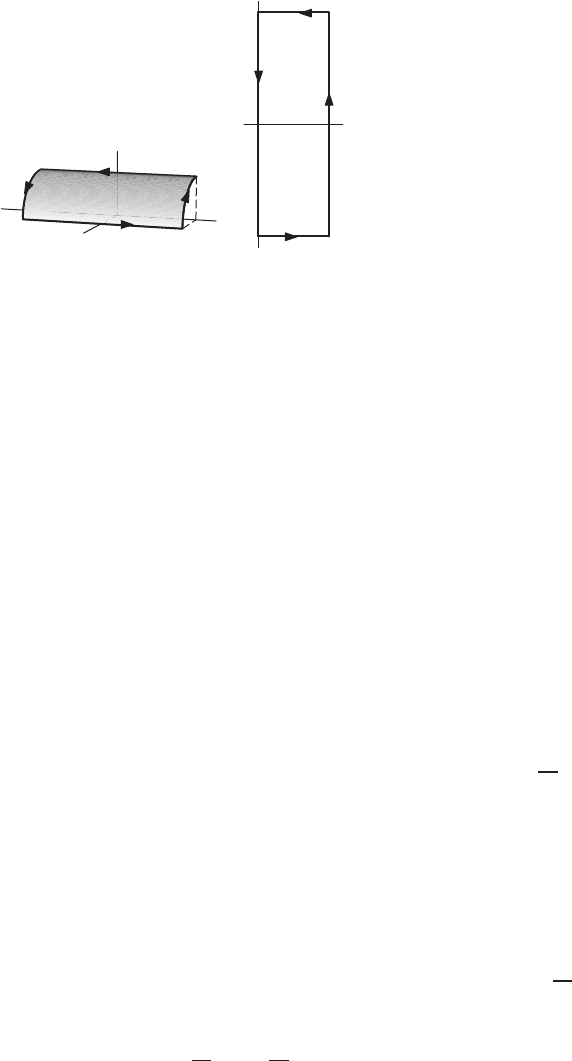
20.2 SOLUTIONS 1811
Job: chap20-sols Sheet: 13 Page: 1811 (August 24, 2012 11 : 19) [ex-2]
4. A sketch of the surface Sand curve Cwhich is the union of four curves C1, C2, C3,and C4, and the region Ris shown
in Figure 20.6.
xy
z
2
1
C3
C1
C2
C4
x
y
R
Figure 20.6
To compute the flux integral, we find d~
A, oriented upward.
d~
A= (2x
~
i+~
k)dxdy and curl ~
F=−y~
i−z~
j−x~
k .
Thus,
ZS
curl ~
F·d~
A=ZS
(−y~
i−z~
j−x~
k)·(2x
~
i+~
k)dxdy
=Z1
0Z2
−2
(−2xy −x)dydx =−2.
The line integral ZS
~
F·d~r is the sum of four integrals along C1, C2, C3,and C4.
On C1:x= 1, z = 0, dx = 0, dz = 0, so
ZS
~
F·d~r =Z2
−2
0dy = 0.
On C2:y= 2, z = 1 −x2, dy = 0, dz =−2xdx, so
ZC2
~
F·d~r =ZC2
2xdx + 2(1 −x2)0 + x(1 −x2)(−2x)dx =Z0
1
(2x−2x2+ 2x4)dx =−11
15 .
On C3:x= 0, z = 1, dx = 0, dz = 0, so
ZC3
~
F·d~r =ZC3
0 + ydy + 0 = Z−2
2
ydy = 0.
On C4:y=−2, z = 1 −x2, dy = 0, dz =−2xdx, so
ZC4
~
F·d~r =ZC4−2xdx −2(1 −x2)0 + x(1 −x2)(−2x)dx =Z1
0
(−2x−2x2+ 2x4)dx =−19
15 .
Hence ZC
~
F·d~r = 0 −11
15 + 0 −19
15 =−2.
Thus, ZC
~
F·d~r =ZS
curl ~
F·d~
A .
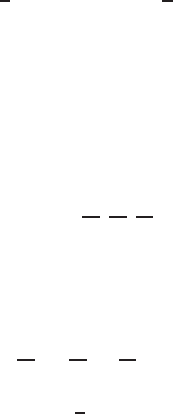
1812 Chapter Twenty /SOLUTIONS
Job: chap20-sols Sheet: 14 Page: 1812 (August 24, 2012 11 : 19) [ex-2]
5. The boundary of Sis C, the circle x2+y2= 1, z = 0, oriented counterclockwise and parameterized in polar coordinates
by
~r (θ) = cos θ
~
i+ sin θ~
j , 0≤θ≤2π,
so,
~r ′(θ) = −sin θ
~
i+ cos θ~
j .
Hence
ZC
~
F·d~r =Z2π
0
(sin θ
~
i+ 0~
j+ cos θ~
k)·(−sin θ
~
i+ cos θ~
j+ 0~
k)dθ
=Z2π
0−sin2θdθ =−π.
Now consider the integral RScurl ~
F·d~
A . Here curl ~
F=−~
i−~
j−~
kand the area vector d~
A, oriented upward, is
given by
d~
A= 2x
~
i+ 2y~
j+~
k dxdy.
If Ris the disk x2+y2≤1, then we have
ZS
curl ~
F·d~
A=ZR
(−~
i−~
j−~
k)·(2x
~
i+ 2y~
j+~
k)dxdy.
Converting to polar coordinates gives:
ZS
curl ~
F·d~
A=Z2π
0Z1
0
(−~
i−~
j−~
k)·(2rcos θ
~
i+ 2rsin θ~
j+~
k)rdrdθ
=Z2π
0Z1
0
(−2rcos θ−2rsin θ−1)rdrdθ
=Z2π
02
3(−cos θ−sin θ)−1
2dθ
=−π.
Thus, we confirm that ZC
~
F·d~r =ZS
curl ~
F·d~
A .
6. Since
curl ~
F=
~
i~
j~
k
∂
∂x
∂
∂y
∂
∂z
x2y2z2
=~
0
the line integral RC~
F·d~r = 0 around any closed curve, including this unit circle.
7. Since
curl ~
F=
~
i~
j~
k
∂
∂x
∂
∂y
∂
∂z
y−x z −y x −z
=−~
i−~
j−~
k ,
and the area vector of the disk x2+y2≤5is ~
A=π(√5)2~
k= 5π~
k , Stokes’ Theorem gives
ZC
~
F·d~r =ZDisk
(−~
i−~
j−~
k)·d~
A= (−~
i−~
j−~
k)·Area vector = (−~
i−~
j−~
k)·5π~
k=−5π.

20.2 SOLUTIONS 1813
Job: chap20-sols Sheet: 15 Page: 1813 (August 24, 2012 11 : 19) [ex-2]
8. If Cis the circle x2+y2= 9 oriented counterclockwise when viewed from above, Stokes’ Theorem gives
ZS
curl ~
F·d~
A=ZC
~
F·d~r .
Only the~
iand ~
jcomponents of ~
F , namely −y~
i+x~
j , contribute to the line integral. Since
−y~
i+x~
j
= 3 on the
circle, and −y~
i+x~
jis tangent to the circle and points in the direction of the orientation of Cwe have
ZS
curl ~
F·d~
A=ZC
~
F·d~r =
−y~
i+x~
j
·Length of curve = 3 ·2π3 = 18π.
Alternatively, the line integral can be evaluated by parameterizing the curve using x= 3 cos t, y = 3 sin tfor 0≤t≤
2π.
9. If Cis the rectangular path around the rectangle, traversed counterclockwise when viewed from above, Stokes’ Theorem
gives ZS
curl ~
F·d~
A=ZC
~
F·d~r .
The ~
kcomponent of ~
Fdoes not contribute to the line integral, and the ~
jcomponent contributes to the line integral only
along the segments of the curve parallel to the y-axis. Thus, if we break the line integral into four parts
ZS
curl ~
F·d~
A=Z(3,0)
(0,0)
~
F·d~r +Z(3,2)
(3,0)
~
F·d~r +Z(0,2)
(3,2)
~
F·d~r +Z(0,0)
(0,2)
~
F·d~r ,
we see that the first and third integrals are zero, and we can replace ~
Fby its ~
jcomponent in the other two
ZS
curl ~
F·d~
A=Z(3,2)
(3,0)
(x+ 7)~
j·d~r +Z(0,0)
(0,2)
(x+ 7)~
j·d~r .
Now x= 3 in the first integral and x= 0 in the second integral and the variable of integration is yin both, so
ZS
curl ~
F·d~
A=Z2
0
10 dy +Z0
2
7dy = 20 −14 = 6.
10. (a) A counterclockwise parameterization of the circle is
x(t) = cos t, y(t) = sin t0≤t≤2π.
Since x′(t) = −sin t, and y′(t) = cos t, we have
ZC
~
F·d~r =Z2π
0
(sin t
~
i−cos t~
j)·(−sin t
~
i+ cos t~
j)dt
=Z2π
0
(−sin2t−cos2t)dt =−2π.
(b) curl ~
F=
~
i~
j~
k
∂
∂x
∂
∂y
∂
∂z
y−x0
= 0
~
i+ 0~
j−2~
k=−2~
k .
(c) Using Stokes’ Theorem, where Ris the region inside the circle oriented upward
ZC
~
F·d~r =ZR
curl ~
F·d~
A=ZR−2~
k·d~
A=−2·Area of circle =−2π.
(d) Stokes’ Theorem, which says that if Cis a closed curve which is the boundary of a surface R, and ~
Fis a smooth
vector field, then ZC
~
F·d~r =ZR
curl ~
F·d~
A .
Here, the orientations of Cand of Rare related by the right-hand rule.
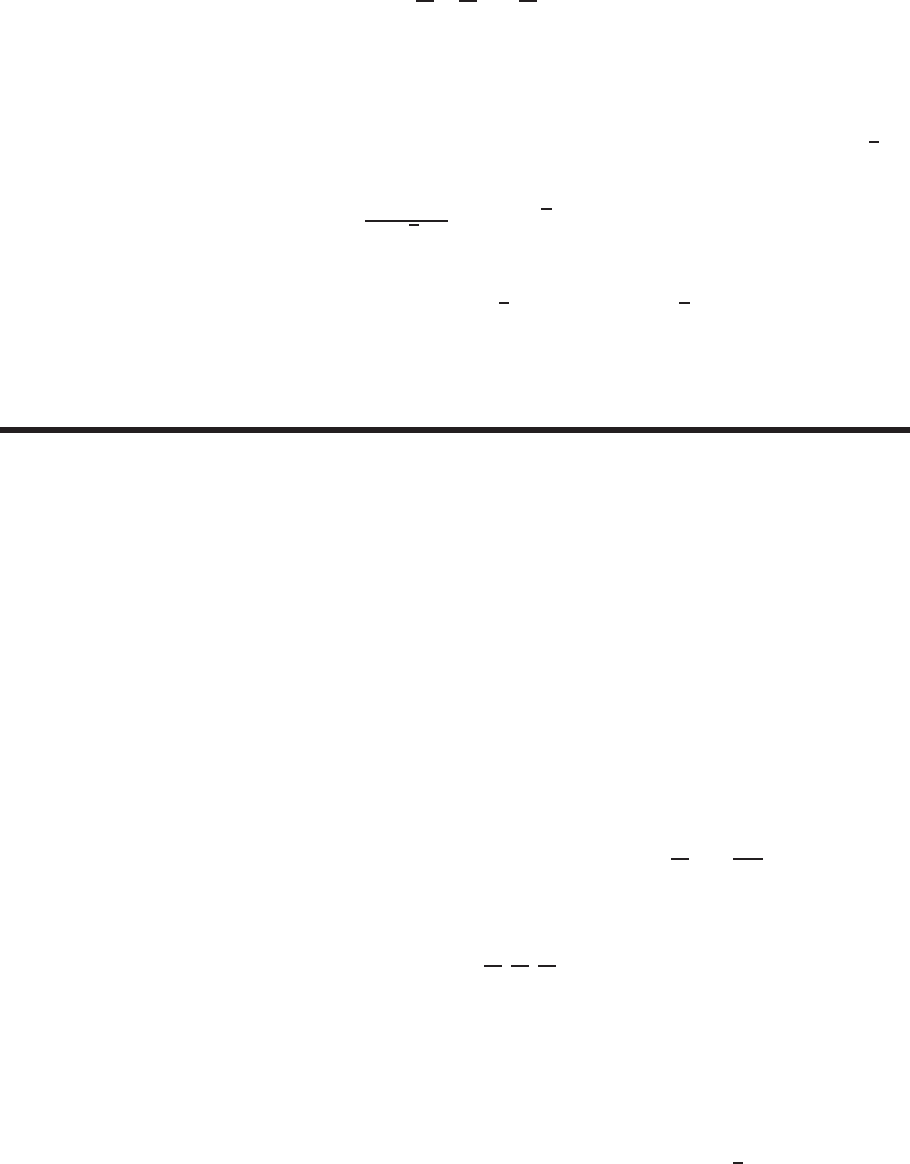
1814 Chapter Twenty /SOLUTIONS
Job: chap20-sols Sheet: 16 Page: 1814 (August 24, 2012 11 : 19) [ex-2]
11. (a) We have
curl ~
F=
~
i~
j~
k
∂
∂x
∂
∂y
∂
∂z
cos x eyx−y−z
=−~
i−~
j .
(b) If Sis the disk on the plane within the circle C, Stokes’ Theorem gives
ZC
~
F·d~r =ZS
curl ~
F·d~
A .
For Stokes’ Theorem, the disk is oriented upward. Since the unit normal to the plane is (
~
i+~
j+~
k)/√3and
the disk has radius 3, the area vector of the disk is
~
A=~
i+~
j+~
k
√3π(32) = 3√3π(
~
i+~
j+~
k).
Thus, using curl ~
F=−~
i−~
j, we have
ZC
~
F·d~r =−~
i−~
j·3√3π(
~
i+~
j+~
k) = −6√3π.
12. No, because the curve Cover which the integral is taken is not a closed curve, and so it is not the boundary of a surface.
Problems
13. By Stokes’ theorem, the circulation of ~
Faround Cis the flux of curl ~
Fthrough the disk Sin the yz-plane enclosed by
C. By the right hand rule, a positive normal vector to the disk points in the direction of the negative x-axis, −~
i. Thus
curl ~
F·d~
A= curl F·(−~
i)dA =−dA, so the flux through Sis negative. So the circulation is negative.
14. (a) We use Stokes’ theorem, with Sthe interior of the circle in the xy-plane, oriented upward. Then
ZC
~
F·d~r =ZS
curl ~
F·d~
A=ZS
((x2+z2)~
j+ 5~
k)·d~
A .
Since d~
A=~
k dA, we have
ZC
~
F·d~r =ZS
5dA = 5 ·Area of S= 5 ·π32= 45π.
(b) Using Stokes’ theorem again, this time with Sas the interior of the circle in the xz-plane, we have
ZC
~
F·d~r =ZS
curl ~
F·d~
A=ZS
((x2+z2)~
j+ 5~
k)·d~
A .
Since d~
A=~
j dx dz, only the ~
jcomponent of curl ~
Fcontributes to the flux. Thus, converting to polars gives
ZC
~
F·d~r =ZS
(x2+z2)dx dz =Z2π
0Z3
0
r2r dr dθ = 2πr4
4
3
0
=81π
2.
15. (a) We have
curl(y~
i+z~
j+x~
k) =
~
i~
j~
k
∂
∂x
∂
∂y
∂
∂z
y z x
=−~
i−~
j−~
k .
(b) Let Sbe the triangular interior of the curve C, oriented upward. Then, by Stokes’ Theorem,
ZC
(y~
i+z~
j+x~
k)·d~r =ZS
curl(y~
i+z~
j+x~
k)·d~
A=ZS−(
~
i+~
j+~
k)·d~
A .
On the triangle d~
A=~
k dA, so
ZS−(
~
i+~
j+~
k)·d~
A=ZS−(
~
i+~
j+~
k)·~
kdA =−Area of triangle =−1
2·4·3 = −6.
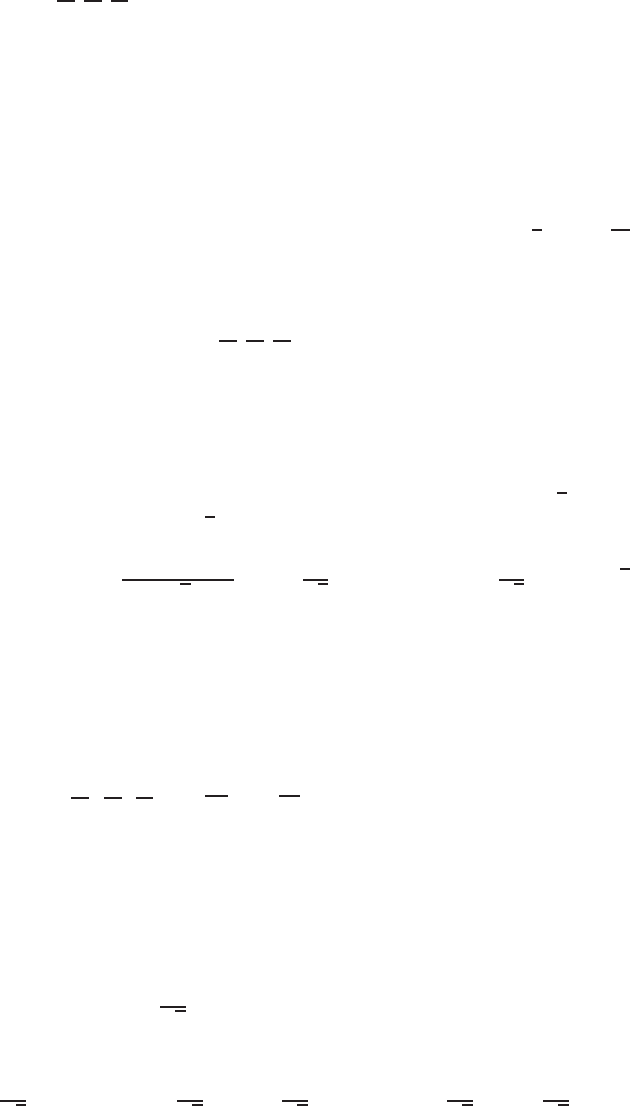
20.2 SOLUTIONS 1815
Job: chap20-sols Sheet: 17 Page: 1815 (August 24, 2012 11 : 19) [ex-2]
16. (a) We have
curl ~
F=
~
i~
j~
k
∂
∂x
∂
∂y
∂
∂z
y z x
=~
i(−1) −~
j(1) + ~
k(−1) = −~
i−~
j−~
k .
(b) (i) Using Stokes’ Theorem, with Srepresenting the disk inside the circle, oriented upward, we have
ZC
~
F·d~r =ZS
curl ~
F·d~
A=ZS
(−~
i−~
j−~
k)·~
k dA =−Area of disk =−4π.
(ii) This is a right triangle in the plane x= 2; it has height 5 and base length 3. Using Stokes’ Theorem, with S
representing the triangle, oriented toward the origin (in the direction −~
i), we have
ZC
~
F·d~r =ZS
curl ~
F·d~
A=ZS
(−~
i−~
j−~
k)·(−~
i dA) = ZS
dA =Area of triangle =1
2·3·5 = 15
2.
17. (a) We have
curl(z~
i+x~
j+y~
k) =
~
i~
j~
k
∂
∂x
∂
∂y
∂
∂z
z x y
=~
i+~
j+~
k .
(b) Let Sbe the square interior of the curve C, oriented toward the origin. Then, by Stokes’ Theorem,
ZC
(z~
i+x~
j+y~
k)·d~r =ZS
curl(z~
i+x~
j+y~
k)·d~
A=ZS
(
~
i+~
j+~
k)·d~
A .
Since the plane has normal vector ~n =~
i+~
j+~
k, a unit normal in this direction is (
~
i+~
j+~
k)/√3. But Sis
oriented toward the origin, so d~
A=−(
~
i+~
j+~
k)/√3dA. Thus
ZS
(
~
i+~
j+~
k)·d~
A=ZS
(
~
i+~
j+~
k)·−(
~
i+~
j+~
k)
√3dA =−3
√3·Area of square =−3
√3·22=−4√3.
18. Since ~
Fis constant, curl ~
F=~
0, so if Sis the disk in the plane enclosed by the circle, Stokes’ Theorem gives
ZC
~
F·d~r =ZS
curl ~
F·d~
A= 0.
19. Since
curl ~
F=
~
i~
j~
k
∂
∂x
∂
∂y
∂
∂z
−y x z
=∂
∂x (x)−∂
∂y (−y)~
k= 2~
k ,
writing Sfor the disk in the plane enclosed by the circle, Stokes’ Theorem gives
ZC
~
F·d~r =ZS
curl ~
F·d~
A=ZS
2~
k·d~
A .
Now d~
A=~n dA, where ~n is the unit vector perpendicular to the plane, so
~n =1
√3(
~
i+~
j+~
k).
Thus
ZC
~
F·d~r =ZS
2~
k·1
√3(
~
i+~
j+~
k)dA =2
√3ZS
dA =2
√3·Area of disk =2
√3·π22=8π
√3.
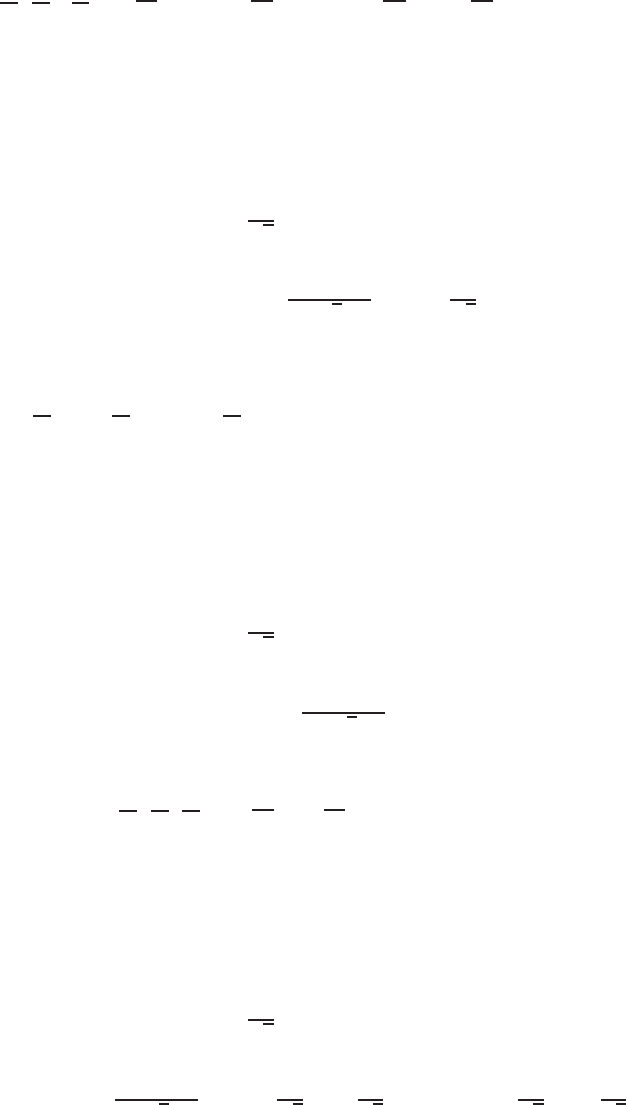
1816 Chapter Twenty /SOLUTIONS
Job: chap20-sols Sheet: 18 Page: 1816 (August 24, 2012 11 : 19) [ex-2]
20. Since
curl ~
F=
~
i~
j~
k
∂
∂x
∂
∂y
∂
∂z
y−x y −x
=∂
∂y (y−x)
~
i−∂
∂x (y−x)~
j+∂
∂x (−x)−∂
∂y (y)~
k=~
i+~
j−2~
k ,
writing Sfor the disk in the plane enclosed by the circle, Stokes’ Theorem gives
ZC
~
F·d~r =ZS
curl ~
F·d~
A=ZS
(
~
i+~
j−2~
k)·d~
A .
Now d~
A=~n dA, where ~n is the unit vector perpendicular to the plane, so
~n =1
√3(
~
i+~
j+~
k).
Thus ZC
~
F·d~r =ZS
(
~
i+~
j−2~
k)·~
i+~
j+~
k
√3dA =ZS
0
√3dA = 0.
21. Since
curl ~
F=
~
i~
j~
k
∂
∂x
∂
∂y
∂
∂z
2y+ex(sin y)−x2y−x+ cos z2
= 2
~
i−(−1)~
j+ (−1−2)~
k= 2
~
i+~
j−3~
k ,
writing Sfor the disk in the plane enclosed by the circle, Stokes’ Theorem gives
ZC
~
F·d~r =ZS
curl ~
F·d~
A=ZS
(2
~
i+~
j−3~
k)·d~
A .
Now d~
A=~n dA, where ~n is the unit vector perpendicular to the plane, so
~n =1
√3(
~
i+~
j+~
k).
Thus ZC
~
F·d~r =ZS
(2
~
i+~
j−3~
k)·~
i+~
j+~
k
√3dA =ZS
0dA = 0.
22. Since
curl ~
F=
~
i~
j~
k
∂
∂x
∂
∂y
∂
∂z
0−z y
=∂
∂y (y)−∂
∂z (−z)~
i−0~
j+ 0~
k= 2
~
i ,
writing Sfor the disk in the plane enclosed by the circle, Stokes’ Theorem gives
ZC
~
F·d~r =ZS
curl ~
F·d~
A=ZS
2
~
i·d~
A .
Now d~
A=~n dA, where ~n is the unit vector perpendicular to the plane, so
~n =1
√3(
~
i+~
j+~
k).
Thus ZC
~
F·d~r =ZS
2
~
i·~
i+~
j+~
k
√3dA =ZS
2
√3dA =2
√3·Area of disk =2
√3π22=8π
√3.
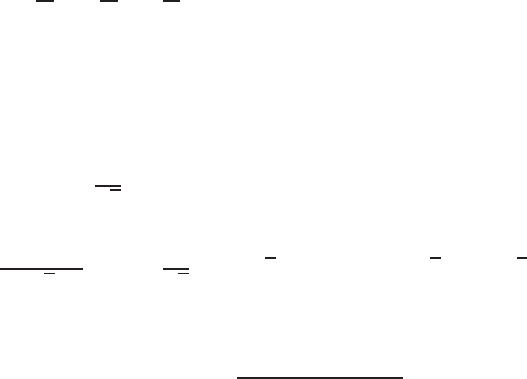
20.2 SOLUTIONS 1817
Job: chap20-sols Sheet: 19 Page: 1817 (August 24, 2012 11 : 19) [ex-2]
23. Since
curl ~
F=
~
i~
j~
k
∂
∂x
∂
∂y
∂
∂z
(z−y) (x−z) (y−x)
= 2
~
i+ 2~
j+ 2~
k ,
writing Sfor the disk in the plane enclosed by the circle, Stokes’ Theorem gives
ZC
~
F·d~r =ZS
curl ~
F·d~
A=ZS
(2
~
i+ 2~
j+ 2~
k)·d~
A .
Now d~
A=~n dA, where ~n is the unit vector perpendicular to the plane, so
~n =1
√3(
~
i+~
j+~
k).
Thus
ZC
~
F·d~r =ZS
(2
~
i+ 2~
j+ 2~
k)·~
i+~
j+~
k
√3dA =ZS
6
√3dA = 2√3·Area of disk = 2√3π22= 8√3π.
24. (a) All 3-space, because (1 + ax2+by2+cz2)is always positive.
(b) We have
grad f= grad(ln(1 + ax2+by2+cz2)) = 2ax
~
i+ 2by~
j+ 2cz~
k
1 + ax2+by2+cz2.
(c) We expect curl(grad f) = 0 because all gradient vector fields satisfy the curl test. Direct calculation gives the same
result.
(d) Vector field ~
F= grad f= grad(ln(1 + ax2+by2+cz2)) with a= 1,b= 2,c= 3. So, if Pand Qare the start
and end points of C:
ZC
~
F·d~r =ZC
grad f·d~r =f
Q
P
.
Since Pis the point on Cwhere t= 0, we have P= (cos 0,sin 0,0) = (1,0,0). Since Qis the point on Cwith
t= 13π/2, we have Q= (cos(13π/2),sin(13π/2),13π/2) = (0,1,13π/2). Thus,
ZC
~
F·d~r = ln(1 + x2+ 2y2+ 3z2)
(0,1,13π/2)
(1,0,0)
= ln(3 + 507π2/4) −ln(2)
25. (a) The equation of the rim, C, is x2+y2= 9,z= 2. This is a circle of radius 3 centered on the z-axis, and lying in the
plane z= 2.
(b) Use Stokes’ Theorem, with Coriented clockwise when viewed from above:
ZS
curl(−y~
i+x~
j+z~
k)·d~
A=ZC
(−y~
i+x~
j+z~
k)·d~r .
Since Cis horizontal, the ~
kcomponent does not contribute to the integral. The remaining vector field, −y~
i+x~
j, is
tangent to C, of constant magnitude ||−y~
i+x~
j|| = 3 on C, and points in the opposite direction to the orientation.
Thus
ZS
curl(−y~
i+x~
j+z~
k)·d~
A=Z(−y~
i+x~
j)·d~r =−3·Length of curve =−3·2π3 = −18π.
26. The curl ~
F(x, y, z)of this vector field is equal to −2~
j. Notice, as a check, that this field rotates in a direction opposite
to the direction of C. Therefore we expect a negative line integral. The surface Sis the disk parallel to the xz plane with
radius 2. The curl points in the opposite direction to the normal vector to the surface with this orientation, so by Stokes’
Theorem,
Circulation around S=ZS
curl ~
F·~
dA =ZS
(−2~
j)·d~
A=ZS−2dA
=−2(Area of circle) =−2π22=−8π.
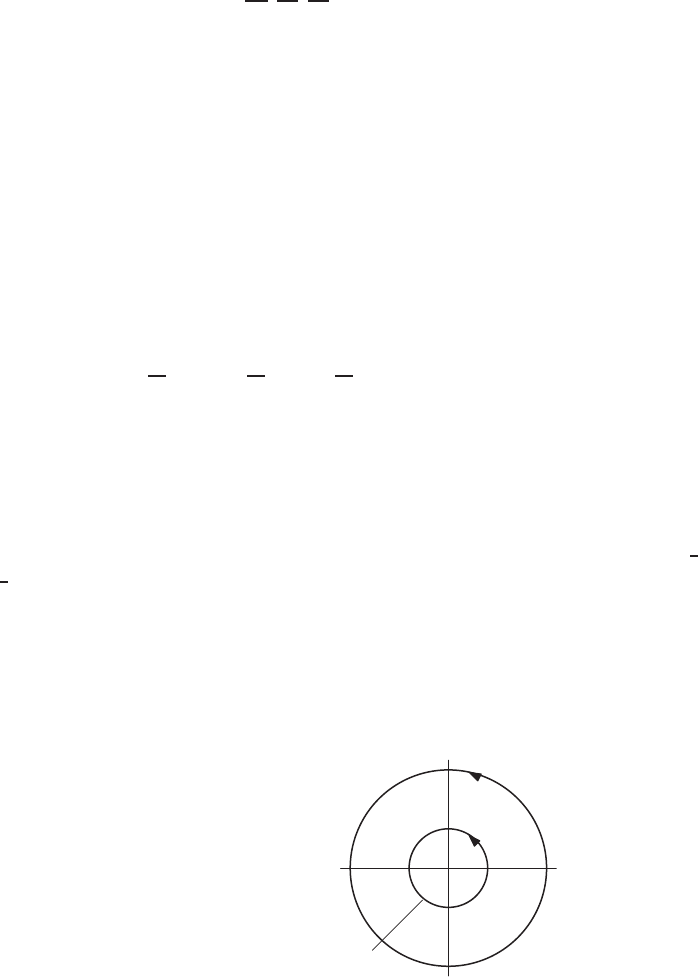
1818 Chapter Twenty /SOLUTIONS
Job: chap20-sols Sheet: 20 Page: 1818 (August 24, 2012 11 : 19) [ex-2]
27. We calculate
curl ~
G=
~
i~
j~
k
∂
∂x
∂
∂y
∂
∂z
xy z 3y
= (3 −1)
~
i−(0 −0)~
j+ (0 −x)~
k= 2
~
i−x~
k .
Let Sbe the surface of the square, oriented in the positive x-direction. Then, by Stokes’ Theorem
ZC
~
G·d~r =ZS
(curl ~
G)·d~
A=ZS
(2
~
i−x~
k)·d~
A .
On the square we have, d~
A=~
i dydz, so
ZC
~
G·d~r =ZS
(2
~
i−x~
k)·~
i dydz = 2 ·Area of square = 2 ·36 = 72.
28. Since ~
Fis the curl of a vector field , we can use Stokes’ Theorem to replace the spherical surface, S, by the disk, D, of
radius 2centered at the origin and oriented upward. Calculating ~
Fgives
~
F=
~
i~
j~
k
∂
∂x
∂
∂y
∂
∂z
x3+ cos(z2)x+ sin(y2)y2sin(x2)
= (2ysin(x2))
~
i−(2xy2cos(x2) + 2zsin(z2))~
j+~
k .
On the horizontal disk D, only the ~
kcomponent of ~
Fcontributes to the flux, so
Flux =ZS
~
F·d~
A=ZD
~
F·d~
A=1·Area of disk = 4π.
29. Use Stokes’ theorem, applied to the surface R, oriented upward. Since curl ~
F=~
kfor ~
F=1
2(−y~
i+x~
j), we have
1
2RC(−y~
i+x~
j)·d~r =RR~
k·d~
A=k~
kk(area of R) = area of R.
30. The region is shown in Figure 20.7, so C2−C1is the boundary of the region, traversed with the region on the left. Thus,
Stokes’ Theorem applies with the region oriented upward, so d~
A=~
k dx dy and
ZC2
~
F·d~r −ZC1
~
F·d~r =ZR
curl ~
F·d~
A=ZR
3~
k·~
k dx dy = 3 ·Area of ring = 3(π52−π22) = 63π.
✒
C1:x2+y2= 4
C2:x2+y2= 25
x
y
Figure 20.7
,
31. Let Sbe the curved surface of the cylinder. The boundary of Sconsists of the curves C1and C2, so Stokes’ Theorem
gives ZS
curl ~
F·d~
A=ZC1
~
F·d~r +ZC2
~
F·d~r .
We calculate the flux of curl ~
Fthrough S. Only the~
iand ~
jcomponents of curl ~
Fcontribute to this flux. The surface S
has equation x2+y2= 4, so the component of curl ~
Fperpendicular to Shas constant magnitude on S
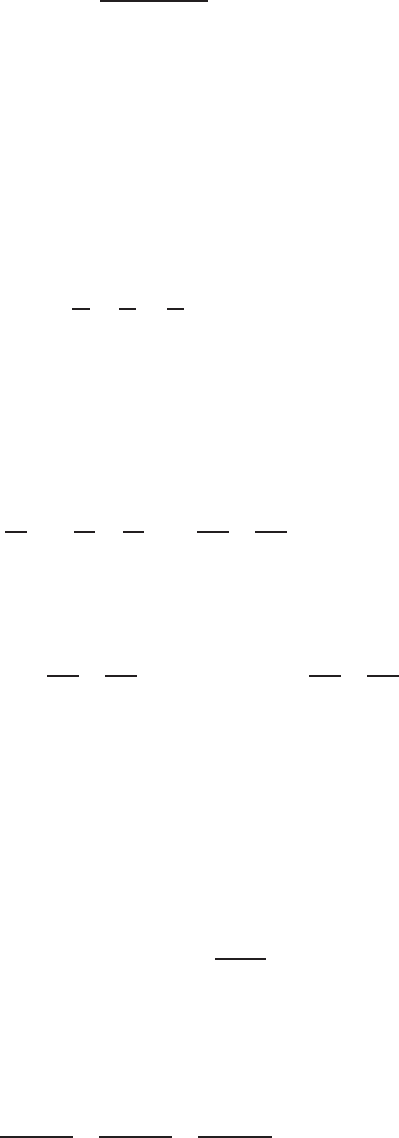
20.2 SOLUTIONS 1819
Job: chap20-sols Sheet: 21 Page: 1819 (August 24, 2012 11 : 19) [ex-2]
||~
F|| =||3x
~
i+ 3y~
j|| =p(3x)2+ (3y)2= 3 ·2 = 6.
The vector d~
Ahas no ~
k-component on S, and it is parallel to 3x
~
i+ 3y~
jon S. Evaluating the flux integral
ZS
curl ~
F·d~
A=||3x
~
i+ 3y~
j|| · Area of S= 6 ·(2π2·5) = 120π.
Thus, ZC1
~
F·d~r +ZC2
~
F·d~r = 120π.
32. (a) Let ~
F=x3
~
i+ sin(y3)~
j+ez3~
k. Then
curl ~
F=
~
i~
j~
k
∂
∂x
∂
∂y
∂
∂z
x3sin(y3)ez3
=~
0.
(b) Since Cis a closed curve, RC~
F·d~r = 0 by Stokes’ Theorem.
(c) The line integral is 0 for any closed curve Cin 3-space.
33. (a) ~
Fhas only~
iand ~
jcomponents, and they do not depend on z. Thus ~
Fis everywhere parallel to the xy-plane, and
takes the same values for every value of z.
(b) We have
curl ~
F=
~
i~
j~
k
∂
∂x
∂
∂y
∂
∂z
F1(x, y)F2(x, y) 0
=∂F2
∂x −∂F1
∂y ~
k .
(c) Since Cis in the xy-plane, oriented counterclockwise when viewed from above, for an area element d~
Ain S, we
have d~
A=~
k dx dy. Thus Stokes’ Theorem says
ZC
~
F·d~r =ZS
curl ~
F·d~
A=ZS∂F2
∂x −∂F1
∂y ~
k·~
kdx dy =ZS∂F2
∂x −∂F1
∂y dx dy.
(d) Green’s Theorem.
34. (a) Notice that the denominators (z2+ 1)2and (z2+ 1) are always positive and so affect the magnitude (but not the
direction) of the motion of each of the terms.
The (−y~
i+x~
j)term represents rotation around the z-axis (counterclockwise when viewed from above). The
−z(x
~
i+y~
j)term represents radial motion (toward the z-axis when z > 0and away when z < 0). The ~
kterm
is downward motion. So ~
Fis a flow rotating inward and downward around the z-axis (for z > 0), like an actual
bathtub drain.
(b) Let Dbe the disk representing the drain, oriented downward. Then the rate at which the water is leaving the bathtub
is the flux of water flowing out of the drain:
ZD
~
F·d~
A=ZD
~
F·(−dA~
k) = ZD
1
z2+ 1 dA.
Because Dis in the xy-plane, z= 0, so
Flux out of D=ZD
dA =πcm3/sec.
(c) We have, in units/sec,
div ~
F=−z
(z2+ 1)2−z
(z2+ 1)2+2z
(z2+ 1)2= 0.
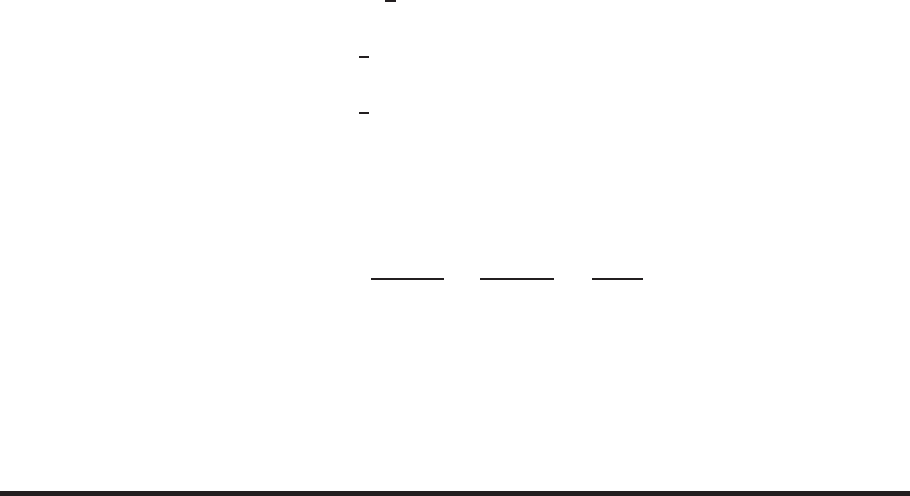
1820 Chapter Twenty /SOLUTIONS
Job: chap20-sols Sheet: 22 Page: 1820 (August 24, 2012 11 : 19) [ex-2]
(d) Let Wbe the closed region bounded by the hemisphere Sof radius 1 lying below the xy-plane and the disk, D, in
the xy-plane representing the drain. Both Sand Dare oriented downward, so by the Divergence Theorem, we have:
0 = ZW
div ~
F dV =Flux out of W−Flux into W
=ZS
~
F·d~
A−ZD
~
F·d~
A
=ZS
~
F·d~
A−π.
Thus, ZS
~
F·d~
A=πcm3/sec.
(e) Since Cis oriented clockwise, we parameterize the circle by ~r (t) = (sin t)
~
i+ (cos t)~
j. In addition, on the drain,
z= 0. Thus,
ZC
~
G·d~r =ZC
1
2(y~
i−x~
j−(x2+y2)~
k)·d~r
=1
2Z2π
0
(cos t
~
i−sin t~
j−~
k)·(cos t
~
i−sin t~
j)dt
=1
2Z2π
0
(sin2t+ cos2t)dt =π.
So, ZC
~
G·d~r =πcm3/sec.
(f) Computing the partial derivatives, we find that
curl ~
G=−y+xz
(z2+ 1)2~
i−yz −x
(z2+ 1)2~
j−1
z2+ 1~
k=~
F .
(g) By Stokes’ Theorem, we have:
ZC
~
G·d~r =ZD
curl ~
G·d~
A=ZD
~
F·d~
A .
Thus, since curl ~
G=~
F, Stoke’s Theorem tells us that the answers to parts (d) and (e) should be equal.
Strengthen Your Understanding
35. The curve Cis not the boundary of a surface, so Stokes’ Theorem does not apply.
36. The orientations of the surface Sand its boundary curve Care not compatible. For Stokes’ Theorem to apply with the
downward orientation of the surface, the boundary Cmust be oriented clockwise in the xy-plane. With the orientations
of Sand Cas given in the problem statement, we have
ZC
~
F·d~r =−ZS
curl ~
F·d~
A .
37. Since curl ~
F= 0 everywhere, Stokes’ Theorem shows that
ZC
~
F·d~r =ZS
curl ~
F·d~
A= 0
for every closed curve Cthat is the boundary of a surface S. For example, we can take Cto be any circle with either
orientation.
38. The surface Scould be the flat disk x2+y2≤1, z = 0 oriented upward, since using the right hand rule would orient the
boundary circle counterclockwise.

20.2 SOLUTIONS 1821
Job: chap20-sols Sheet: 23 Page: 1821 (August 24, 2012 11 : 19) [chap20-sols]
39. True. By Stokes’ Theorem, the circulation of ~
Faround Cis the flux of curl ~
Fthrough the flat disc Sin the xy-plane
enclosed by the circle. An area element for Sis d~
A=±~
k dA, where the sign depends on the orientation of the circle.
Since curl ~
Fis perpendicular to the z-axis, curl ~
F·d~
A=±(curl ~
F·~
k)dA = 0, so the flux of curl ~
Fthrough Sis
zero, hence the circulation of ~
Faround Cis zero.
40. True. On a small patch of Sthat includes the boundary circle, the positive normal is outward. Letting the thumb of the
right hand point in this direction makes the fingers curl in the counterclockwise direction.
41. False. Using the right-hand rule gives C1oriented clockwise and C2oriented counterclockwise when viewed from the
positive y-axis.
42. False. The curl needs to be in the flux integral, not the line integral, for a correct statement of Stokes’ theorem: RC~
F·d~r =
RScurl ~
F·d~
A .
43. True. By Stokes’ theorem, both flux integrals are equal to the line integral RC~
F·d~r , where Cis the circle x2+y2= 1,
oriented counterclockwise when viewed from the positive z-axis.
44. True. By Stokes’ theorem, the flux integral is equal to the line integral RC~
F·d~r , where Cis the boundary of the closed
sphere. Since the sphere has no boundary curve, the line integral is zero. Alternatively, the closed sphere can be divided
into two hemispheres S1(the top half with upward orientation) and S2(the bottom half with downward orientation.) Then
S1and S2both have the circle C(x2+y2= 1, z = 0) as their common boundary, except that for S1,Cis oriented
counterclockwise when viewed from above, and as the boundary of S2,Cis oriented clockwise. Then, using Stokes’
theorem on S1and S2gives RScurl ~
F·d~
A=RS1curl ~
F·d~
A+RS2curl ~
F·d~
A=RC~
F·d~r −RC~
F·d~r = 0.
The same result can be obtained using the Divergence theorem and the fact that div curl ~
F= 0.
45. True. Let Dbe the interior disk of C, oriented by the right hand rule. By Stokes’ theorem, RC~
F·d~r =RDcurl ~
F·d~
A ,
and RC~
G·d~r =RDcurl ~
G·d~
A . Since curl ~
F=curl ~
G, we have RC~
F·d~r =RC~
G·d~r .
46. True. Let Sbe the rectangular region inside C, oriented by the right hand rule. By Stokes’ theorem, RC~
F·d~r =
RScurl ~
F·d~
A= 0.
47. False. The condition that RC~
F·d~r = 0 implies, by Stokes’ theorem, that RScurl ~
F·d~
A= 0.However, curl ~
Fneed
not be ~
0for this to occur. For example, let ~
F=y~
i, and let Sbe the upper unit hemisphere x2+y2+z2= 1, z ≥0
oriented upward. Then Cis the circle x2+y2= 1, z = 0 oriented counterclockwise when viewed from above. The line
integral RCy~
i·d~r = 0,but curl ~
F=−~
k .
48. Since
curl ~
F=
~
i~
j~
k
∂
∂x
∂
∂y
∂
∂z
2z+ 3y x −z6y−7x
= (6 −(−1))
~
i−(−7−2)~
j+ (1 −3)~
k= 7
~
i+ 9~
j−2~
k ,
by Stokes’ Theorem, if Sis the flat interior of the circle, with area vector ~
A,
ZC
~
F·d~r =ZS
curl ~
F·d~
A=ZS
(7
~
i+ 9~
j−2~
k)·d~
A= (7
~
i+ 9~
j−2~
k)·~
A .
This is a maximum if ~
Ais parallel to curl ~
F= 7
~
i+ 9~
j−2~
k, so curl ~
Fis the normal to the plane of the circle. Since
the plane containing the circle is through the origin, its equation is
7x+ 9y−2z= 0.
To give the orientation of Sshown by curl ~
F, notice that curl ~
Fpoints downward (because the z-component is negative).
Therefore, the circle must be oriented counterclockwise when seen from the negative z-axis, or clockwise from the positive
z-axis.
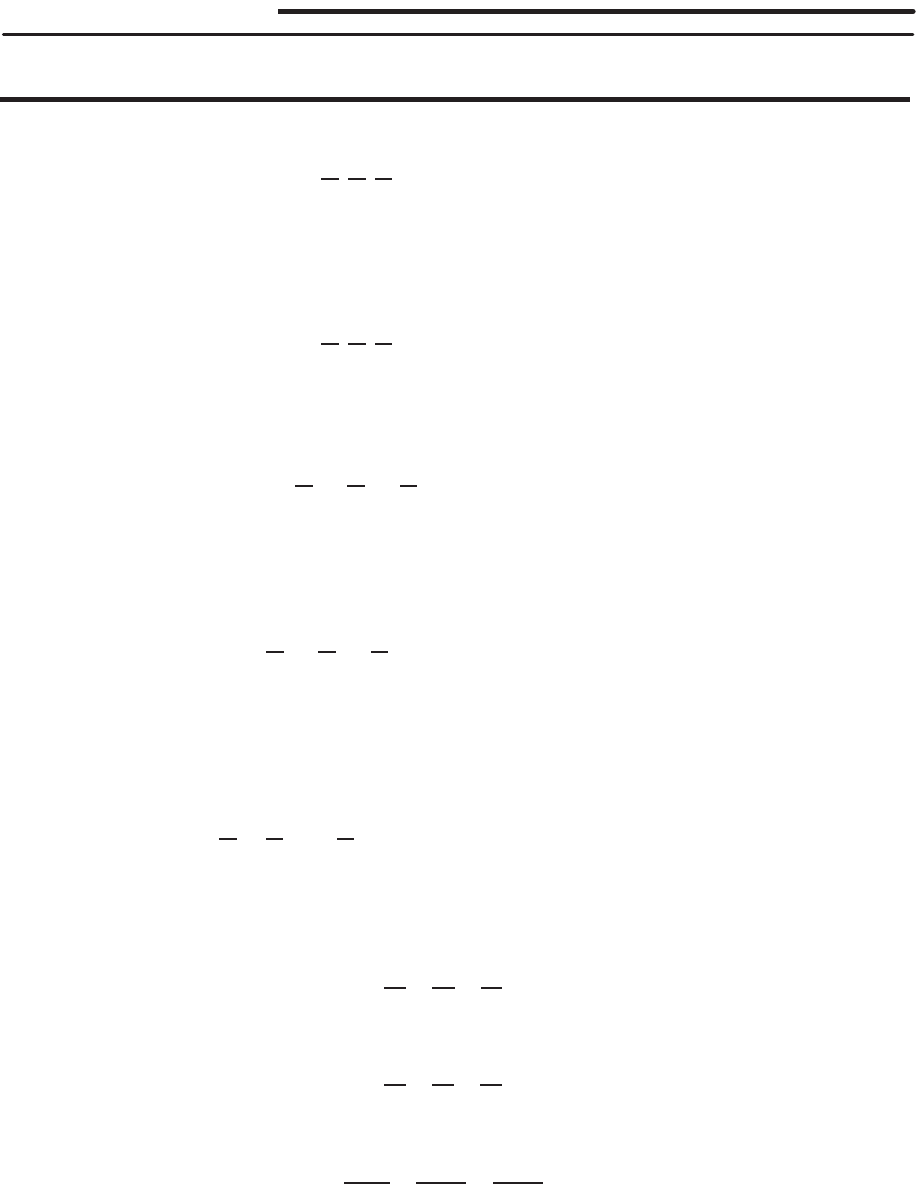
1822 Chapter Twenty /SOLUTIONS
Job: chap20-sols Sheet: 24 Page: 1822 (August 24, 2012 11 : 19) [ex-3]
Solutions for Section 20.3
Exercises
1. We have
curl ~
F=
~
i~
j~
k
∂
∂x
∂
∂y
∂
∂z
2x z y
= (1 −1)
~
i+ (0 −0)~
j+ (0 −0)~
k=~
0.
Since curl ~
F=~
0and ~
Fis defined everywhere, we know by the curl test that ~
Fis a gradient field. In fact, ~
F= gradf,
where f(x, y, z) = x2+yz, so fis a potential function for ~
F.
2. We have
curl ~
F=
~
i~
j~
k
∂
∂x
∂
∂y
∂
∂z
y z x
= (0 −1)
~
i+ (0 −1)~
j+ (0 −1)~
k6=~
0.
Since curl ~
F6=~
0, by the curl test ~
Fis not a gradient field.
3. We have
curl ~
F=
~
i~
j~
k
∂
∂x
∂
∂y
∂
∂z
y+ 2z x +z2x+y
= (1 −1)
~
i+ (2 −2)~
j+ (1 −1)~
k=~
0.
Since curl ~
F=~
0and ~
Fis defined everywhere, we know by the curl test that ~
Fis a gradient field. In fact,
~
F= gradf, where f(x, y, z) = xy +yz + 2xz, so fis a potential function for ~
F.
4. We have
curl ~
F=
~
i~
j~
k
∂
∂x
∂
∂y
∂
∂z
y−2z x −z2x−y
= (−1−(−1))
~
i+ (−2−2)~
j+ (1 −1)~
k6=~
0.
Since curl ~
F6=~
0, by the curl test ~
Fis not a gradient field.
5. Since curl ~
G= 2~
k6=~
0, the vector field ~
Gis not a gradient field.
6. We have
curl ~
F=
~
i~
j~
k
∂
∂x
∂
∂y
∂
∂z
yz xz +z2yx + 2yz
= ((x+ 2z)−(x+ 2z))
~
i−(y−y)~
j+ (z−z)~
k=~
0.
Since curl ~
F=~
0and ~
Fis defined everywhere, we know by the curl test that ~
Fis a gradient field. In fact, ~
F= gradf,
where f(x, y, z) = xyz +yz2, so fis a potential function for ~
F.
7. We have
div ~
F=∂z
∂x +∂x
∂y +∂y
∂z = 0 + 0 + 0 = 0.
Since div ~
F= 0, by the divergence test ~
Fis a curl field.
8. We have
div ~
F=∂z
∂x +∂y
∂y +∂x
∂z = 0 + 1 + 0 = 1.
Since div ~
F6= 0, by the divergence test ~
Fis not a curl field.
9. We have
div ~
F=∂(2x)
∂x +∂(−y)
∂y +∂(−z)
∂z = 2 −1−1 = 0.
Since div ~
F= 0, by the divergence test ~
Fis a curl field.
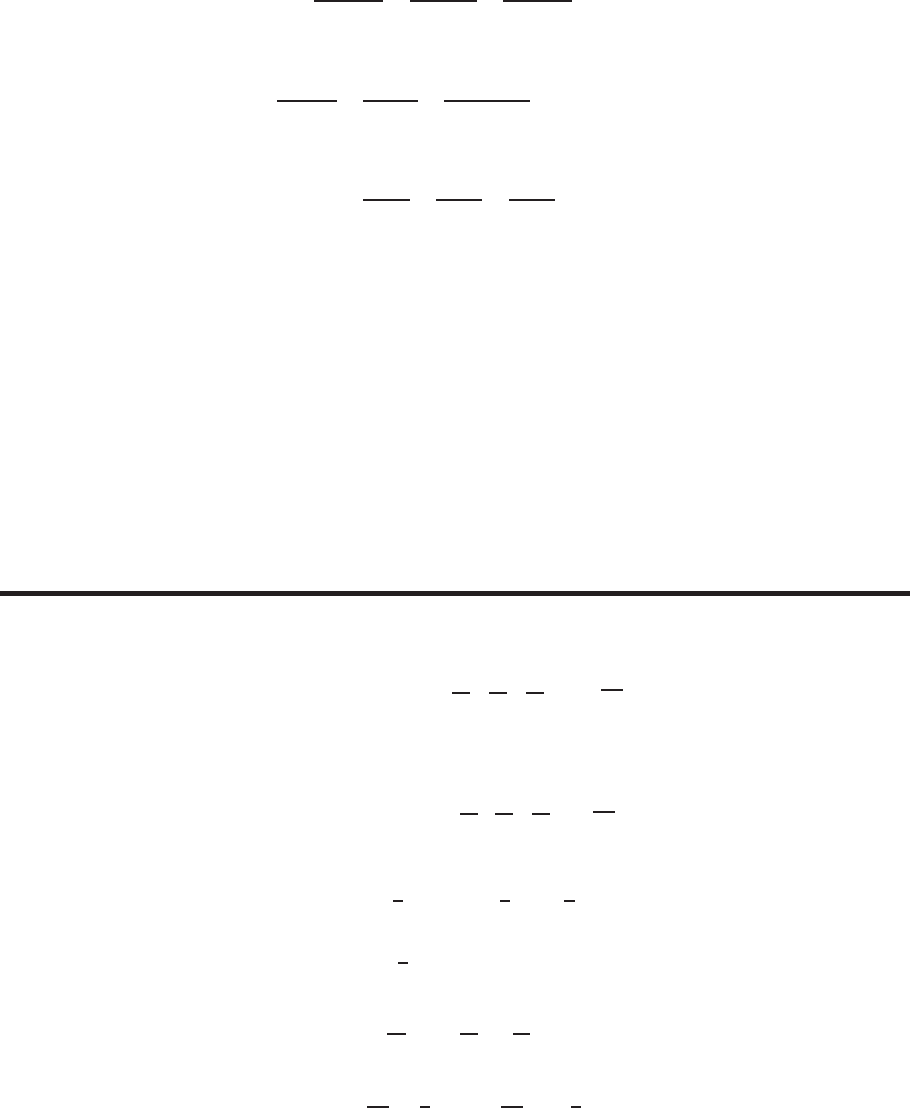
20.3 SOLUTIONS 1823
Job: chap20-sols Sheet: 25 Page: 1823 (August 24, 2012 11 : 19) [ex-3]
10. We have
div ~
F=∂(x+y)
∂x +∂(y+z)
∂y +∂(x+z)
∂z = 1 + 1 + 1 = 3.
Since div ~
F6= 0, by the divergence test ~
Fis not a curl field.
11. We have
div ~
F=∂(−xy)
∂x +∂(2yz)
∂y +∂(yz −z2)
∂z =−y+ 2z+ (y−2z) = 0.
Since div ~
F= 0, by the divergence test ~
Fis a curl field.
12. We have
div ~
F=∂(xy)
∂x +∂(xy)
∂y +∂(xy)
∂z =y+x+ 0.
Since div ~
F6= 0, by the divergence test ~
Fis not a curl field.
13. The region is all points above the xy-plane. Any curve in that region can be contracted in that region to a point, so the curl
test can be used. Also, any surface in that region bounds a solid in that region, so the divergence test can be used.
14. A small circle in the xz-plane centered at the origin surrounds the y-axis and cannot be contracted in the region to a point,
so the curl test cannot be applied. A closed surface in the region bounds a solid in the region so the divergence test can be
applied.
15. Any closed curve in the region can be contracted in the region to a point; even a small circle around the z-axis can be
contracted by pulling it around the end of the positive z-axis. Thus, the curl test can be applied. A closed surface in the
region bounds a solid in the region so the divergence test can be applied
16. Any closed curve be contracted in the region to a point. Even a small circle around the missing segment of the x-axis
can be contracted by pulling it around either end of the segment. Thus, the curl test can be applied. A sphere of radius 2
centered at the origin contains inside it the missing segment, so it does not bound a solid in the region. Thus, the divergence
test cannot be applied.
Problems
17. (a) We calculate the curl of each of these vector fields.
curl ~
A= curl(−by~
i) =
~
i~
j~
k
∂
∂x
∂
∂y
∂
∂z
−by 0 0
=−∂
∂y (−by)~
k=b~
k .
(b)
curl ~
A= curl(bx~
j) =
~
i~
j~
k
∂
∂x
∂
∂y
∂
∂z
0bx 0
=∂
∂x (bx)~
k=b~
k .
(c)
−1
2~r ×~
B=−1
2yb
~
i+1
2xb~
j
curl ~
A= curl 1
2~
B×~r
=
~
i~
j~
k
∂
∂x
∂
∂y
∂
∂z
−(1/2)by (1/2)bx 0
=∂
∂x 1
2bx−∂
∂y −1
2by~
k=b~
k .
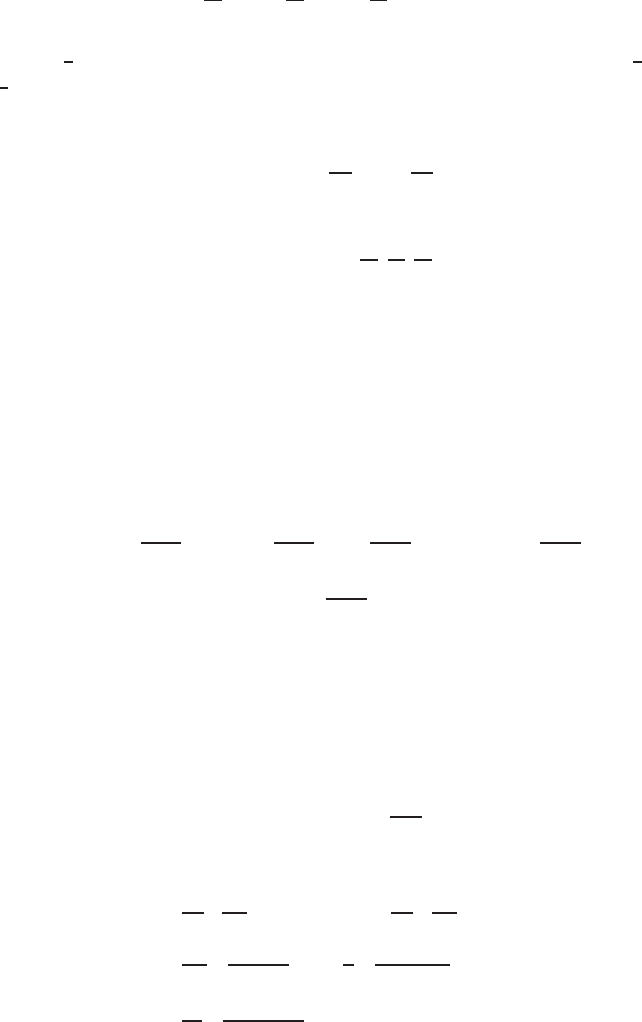
1824 Chapter Twenty /SOLUTIONS
Job: chap20-sols Sheet: 26 Page: 1824 (August 24, 2012 11 : 19) [ex-3]
18. Let ~v =a
~
i+b~
j+c~
kand try
~
F=~v ×~r = (a
~
i+b~
j+c~
k)×(x
~
i+y~
j+z~
k) = (bz −cy)
~
i+ (cx −az)~
j+ (ay −bx)~
k .
Then
curl ~
F=
~
i~
j~
k
∂
∂x
∂
∂y
∂
∂z
bz −cy cx −az ay −bx
= 2a
~
i+ 2b~
j+ 2c~
k .
Taking a= 1, b =−3
2, c = 2 gives curl ~
F= 2
~
i−3~
j+ 4~
k, so the desired vector field is ~
F= (−3
2z−2y)
~
i+ (2x−
z)~
j+ (y+3
2x)~
k.
19. In Example 3 on page 1051 we showed that curl(~
b×~r ) = 2~
b. Thus (1/2)~
b×~r is a vector potential for ~
B.
20. Note that
div(2y~
i+ 4x~
j) = ∂
∂x (2y) + ∂
∂y (4x) = 0
and
curl(3x
~
i+ 9y~
j) =
~
i~
j~
k
∂
∂x
∂
∂y
∂
∂z
3x9y0
=~
0,
so (3x
~
i+ 9y~
j) + (2y~
i+ 4x~
j)is the required decomposition.
21. Since div ~
G= 2x+ 2y+ 2z6= 0, there is not a vector potential for ~
G.
22. Since div ~
F= 2 + 3 −5 = 0, a vector potential does exist. One such is the vector field ~
H= (−xy + 5yz)
~
i+ (2xy +
xz2)~
k, but there are many others.
23. (a) Yes. To show this, we use a version of the product rule for curl (Problem 29 on page 1805):
curl(φ~
F) = φcurl ~
F+ (grad φ)×~
F ,
where φis a scalar function and ~
Fis a vector field. So
curl q~
r
k~r k3= curl q
k~r k3~r =q
k~r k3curl ~r + grad q
k~r k3×~r
=~
0 + qgrad 1
k~r k3×~r
Since the level surfaces of 1/k~r k3are spheres centered at the origin, grad(1/k~r k3)is parallel to ~r , so grad(1/k~r k3)×
~r =~
0. Thus, curl ~
E=~
0.
(b) Yes. The domain of ~
Eis 3-space minus (0,0,0). Any closed curve in this region is the boundary of a surface
contained entirely in the region. (If the first surface you pick happens to contain (0,0,0), change its shape slightly to
avoid it.)
(c) Yes. Since ~
Esatisfies both conditions of the curl test, it must be a gradient field. In fact,
~
E= grad −q1
k~r k.
24. We must show curl ~
A=~
B.
curl ~
A=∂
∂y −I
cln(x2+y2)~
i−∂
∂x −I
cln(x2+y2)~
j
=−I
c2y
x2+y2~
i+I
c2x
(x2+y2)~
j
=2I
c−y~
i+x~
j
x2+y2
=~
B .
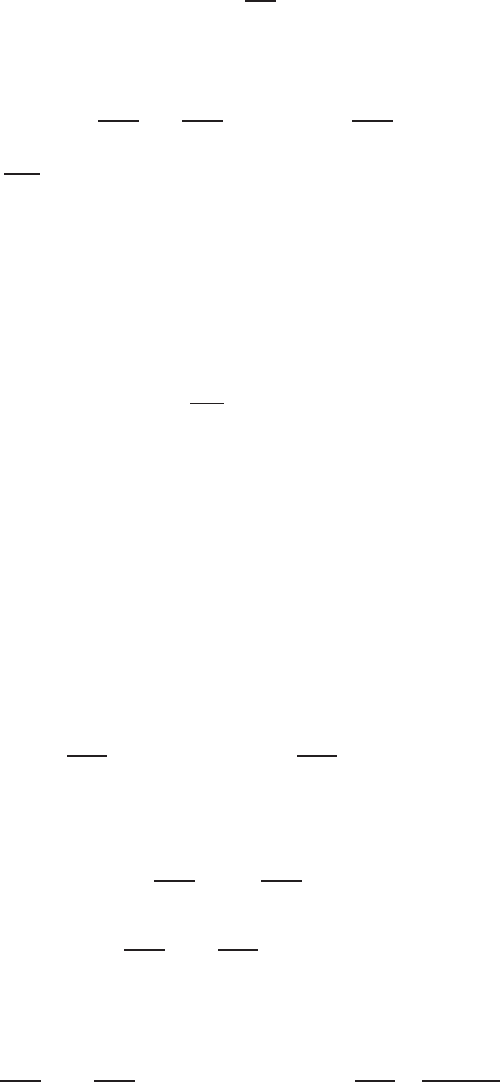
20.3 SOLUTIONS 1825
Job: chap20-sols Sheet: 27 Page: 1825 (August 24, 2012 11 : 19) [ex-3]
25. (a) Yes. This is the case p= 2 of Example 5 on page 1052.
(b) No. The domain of ~
Bis 3-space minus the z-axis. A closed curve Cwhich surrounds the z-axis cannot be contracted
to a point without hitting the z-axis, so it cannot remain at all times within the domain.
(c) No. In Example 2 on page 1058 we found that if Cis a circle around the origin,
ZC
~
B·d~r =4πI
c.
Thus ~
Bhas non-zero circulation around C, and hence cannot be a gradient field.
26. (a) Using the product rule from Problem 29 on page 1805, we find
curl ~
E= curl ~r
k~r kp=1
k~r kpcurl ~r + grad 1
k~r kp×~r .
Now curl ~r =~
0and grad 1
k~r kpis parallel to ~
r, so both terms are zero. Thus curl ~
E=~
0.
(b) The domain of ~
Eis 3-space minus the origin if p > 0, and it is all of 3-space if p≤0.
(c) Both domains have the property that any closed curve can be contracted to a point without hitting the origin, so ~
E
satisfies the curl test for all p. Since ~
Ehas constant magnitude r1−pon the sphere of radius rcentered at the origin,
and is parallel to the outward normal at every point of the sphere, the sphere must be a level surface of the potential
function φ, that is, φis a function of ralone. Further, since k~
Ek=r1−p, a good guess is
φ(r) = Zr1−pdr,
that is,
φ(r) = r2−p
2−pif p6= 2
ln rif p= 2.
You can check that this is indeed a potential function for ~
Eby checking that grad φ=~
E.
27. We apply Stokes’ Theorem to the vector field ~
F(x, y, z) = u(x, y)
~
i+v(x, y)~
j+ 0~
k. Since ∂u/∂z =∂v/∂z = 0, it
is straightforward to compute that curl ~
F= (∂v/∂x −∂u/∂y)~
k. Therefore, by Stokes’ Theorem,
ZC
(u
~
i+v~
j)·d~r =ZR
(∂v/∂x −∂u/∂y)~
k·d~
A
Since the surface Ris in the xy-plane, oriented upward, d~
A=dxdy~
k. The result follows.
28. (a) Although div ~
B= 0, the vector field ~
Bdoes not satisfy the divergence test because its domain is 3-space minus the
origin, which does not have the required property that every closed surface is the boundary of a solid region which
is entirely contained within the domain. For example, the solid region inside a sphere centered at the origin contains
the origin, hence is not in the domain of ~
B.
(b) Using the product rule from Problem 29 on page 1805, we find
curl ~
A=1
k~r k3curl(µ×~r ) + grad 1
k~r k3×(~µ ×~r ).
By Example 3 on page 1051,
curl(~µ ×~r ) = 2~µ
and by Problem 68 on page 796
grad 1
k~r k3=−31
k~r k5~r .
So
curl ~
A= 2 ~µ
k~r k3−31
k~r k5~r ×(~µ ×~r ).
From Problem 47 on page 750, we have
~r ×(~µ ×~r ) = k~r k2~µ −(~µ ·~r )~r .
So
curl ~
A= 2 ~µ
k~r k3−31
k~r k5(k~r k2~µ −(~µ ·~r )~r ) = −~µ
k~r k3+3(~µ ·~r )~r
k~r k5.
(c) No. The divergence test says a vector field must be a curl field if it satisfies the conditions of the test; it does not say
the vector field cannot be a curl field if the vector field fails to satisfy the test.
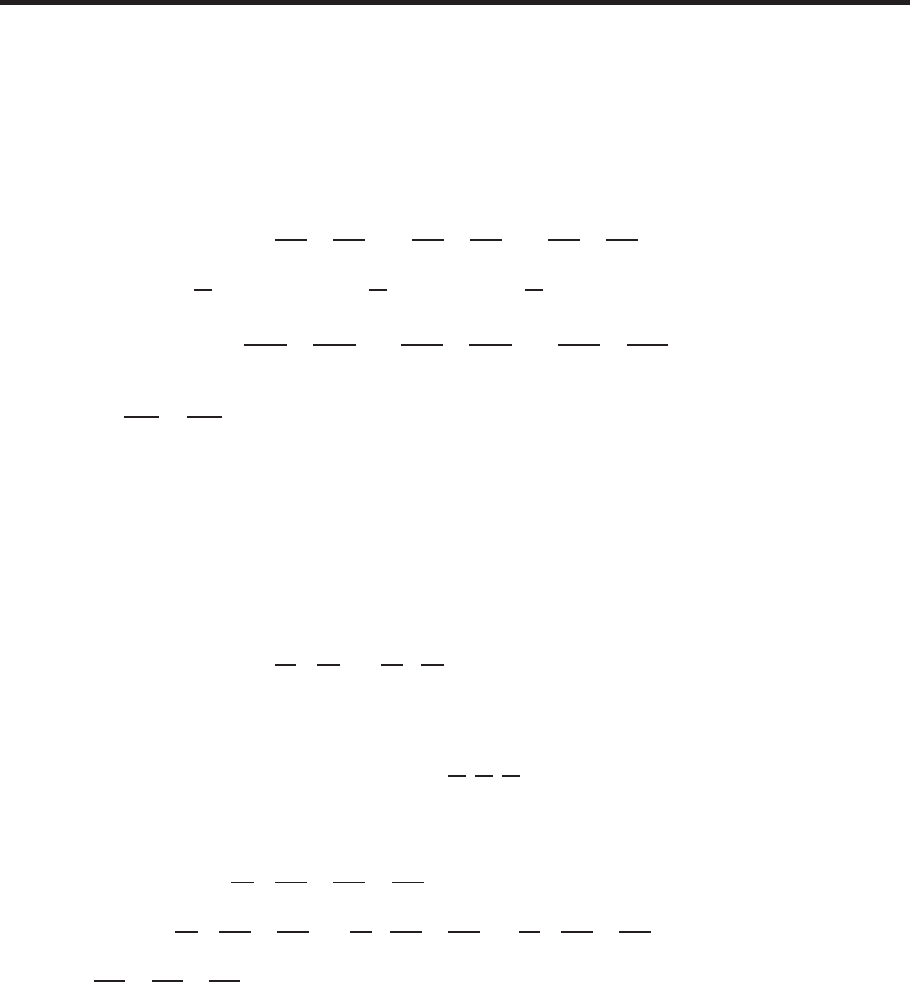
1826 Chapter Twenty /SOLUTIONS
Job: chap20-sols Sheet: 28 Page: 1826 (August 24, 2012 11 : 19) [chap20-sols]
29. (a) Since curl grad ψ= 0 for any function ψ,curl( ~
A+ grad ψ) = curl ~
A+ curl grad ψ= curl ~
A=~
B.
(b) We have
div( ~
A+ grad ψ) = div ~
A+ div grad ψ= div ~
A+∇2ψ.
Thus ψshould be chosen to satisfy the partial differential equation
∇2ψ=−div ~
A .
Strengthen Your Understanding
30. Since div curl ~
F= 0 for any smooth vector field ~
F , and div x
~
i= 1 6= 0, there can be no vector field ~
Fsuch that
curl ~
F=x
~
i.
31. The expression curl div ~
Fis meaningless, because div ~
Fis a scalar function, but curl is only defined for vector fields.
32. If ~
F=x
~
i+y~
j , then div ~
F6= 0, so ~
Fis not the curl of another vector field.
33. If f(x, y, z) = x2, then grad f= 2x
~
iand div grad f= 2 6= 0.
34. True. For example, take ~
F=y~
k.
35. False. To see why, write ~
F=F1
~
i+F2~
j+F3~
k . Then curl ~
F=x
~
igives
∂F3
∂y −∂F2
∂z =x;∂F1
∂z −∂F3
∂x = 0; ∂F2
∂x −∂F1
∂y = 0.
Now take the partial ∂
∂x of the first equation, ∂
∂y of the second and ∂
∂z of the third. This gives
∂2F3
∂x∂y −∂2F2
∂x∂z = 1; ∂2F1
∂y∂z −∂2F3
∂y∂x = 0; ∂2F2
∂z∂x −∂2F1
∂z∂y = 0.
Assuming the continuity of the second order partials, the equality of mixed partials in the second and third equations
shows that ∂2F3
∂x∂y =∂2F2
∂x∂z , which contradicts the first equation. Thus there cannot be a vector field ~
Fwith curl ~
F=x
~
i .
36. False. The condition that RScurl ~
F·d~
A= 0 implies, by Stokes’ theorem, that RC~
F·d~r = 0.However, ~
Fneed not be a
gradient field for this to occur. For example, let ~
F=x~
k, and let Sbe the upper unit hemisphere x2+y2+z2= 1, z ≥0
oriented upward. Then Cis the circle x2+y2= 1, z = 0 oriented counterclockwise when viewed from above. The line
integral RCx~
k·d~r = 0,since the field ~
Fis everywhere perpendicular to C. The curl of ~
Fis the constant field −~
j,
so ~
Fis not a gradient field. Yet we have RS−~
j·d~
A= 0,since the constant field −~
jflows in, and then out of the
hemisphere S.
37. True. By Stokes’ theorem, RScurl ~
F·d~
A=RC~
F·d~r , where Cis one or more closed curves that form the boundary
of S. Since ~
Fis a gradient field, its line integral over any closed curve is zero.
38. (a) Is zero, since, for example, ∂
∂z ∂f
∂y −∂
∂y ∂f
∂z = 0.
(b) Is not zero. Let ~
F=x~
j+x~
k, then
curl ~
F=
~
i~
j~
k
∂
∂x
∂
∂y
∂
∂z
0x x
=−~
j+~
k ,
so ~
F×curl ~
F6=~
0.
(c) Has components like ∂
∂x ∂F1
∂x +∂F2
∂y +∂F3
∂z , not zero.
(d) Is zero, since ∂
∂x ∂F3
∂y −∂F2
∂z +∂
∂y ∂F1
∂z −∂F3
∂x +∂
∂z ∂F2
∂x −∂F1
∂y = 0.
(e) Is ∂2f
∂x2+∂2f
∂y2+∂2f
∂z2, not zero.
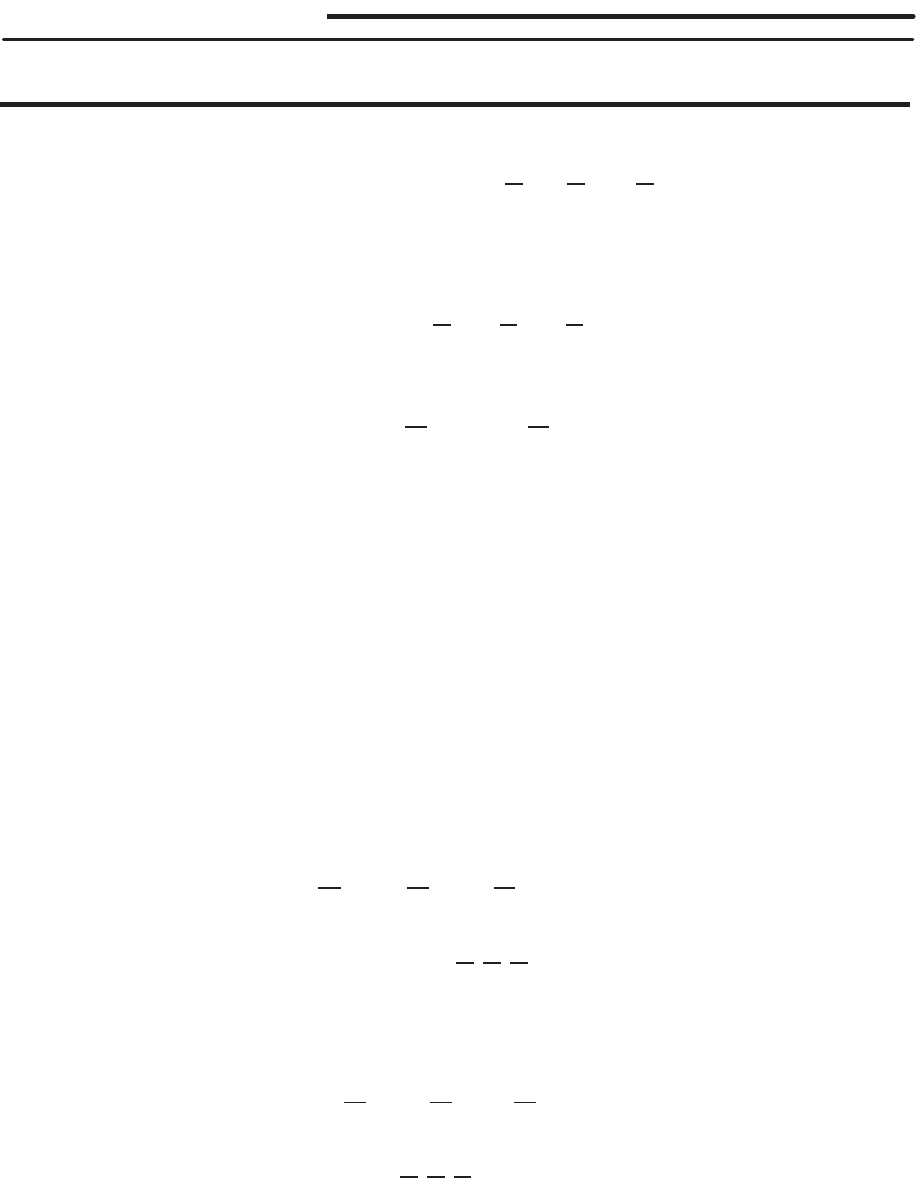
SOLUTIONS to Review Problems for Chapter Twenty 1827
Job: chap20-sols Sheet: 29 Page: 1827 (August 24, 2012 11 : 19) [ex-misc]
Solutions for Chapter 20 Review
Exercises
1. We have
curl((x+y)
~
i−(y+z)~
j+ (x+z)~
k) =
~
i~
j~
k
∂
∂x
∂
∂y
∂
∂z
x+y−(y+z) (x+z)
=~
i−~
j−~
k
2. We want the ~
jcomponent of curl ~n . Since
curl ~n =
~
i~
j~
k
∂
∂x
∂
∂y
∂
∂z
2x+ 3y4y+ 5z6z+ 7x
,
the ~
jcomponent is
(curl ~n )·~
j=−∂
∂x (6z+ 7y)−∂
∂z (2x+ 3y)=−7.
3.Fields with zero curl: (c),(d),(f)because these don’t appear to be swirling.
4. Fields (a),(c),(e)because they do not appear to be exploding or collapsing.
5. C2, C3, C4, C6,since line integrals around C1and C5are clearly nonzero. You can see directly that RC2
~
F·d~r and
RC6
~
F·d~r are zero, because C2and C6are perpendicular to their fields at every point.
6. Not defined, since we can’t take the gradient of a vector function.
7. Defined; scalar because ~
F(~r )×~
G(~r )is a vector field; the integral represents the flux—a scalar—through the surface
S.
8. Defined; scalar because grad fis a vector field, so (grad f)×~r is a vector field, so we can calculate its divergence,
giving a scalar.
9. Defined; vector since curl ~
Fis a vector and the cross product of two vectors is a vector.
10. The circulation around any square with sides parallel to the axes and centered at the point is zero because the line integrals
on the top and bottom sides add to zero and the line integrals on the left and right sides add to zero. We suspect that the
vector field has zero curl.
11. The circulation around the boundary of any square with sides parallel to the axes and enclosing the point is nonzero
because the vectors at the bottom are larger than those at the top, so we suspect a nonzero curl at this point.
12. We have
div ~
F=∂
∂x x2+∂
∂y y3+∂
∂z z4= 2x+ 3y2+ 4z3,
curl ~
F=
~
i~
j~
k
∂
∂x
∂
∂y
∂
∂z
x2y3z4
=~
0.
So ~
Fis not solenoidal, but ~
Fis irrotational.
13. We have
div ~
F=∂
∂x (xy) + ∂
∂y (yz) + ∂
∂z (zx) = y+z+x,
curl ~
F=
~
i~
j~
k
∂
∂x
∂
∂y
∂
∂z
xy yz zx
=−y~
i−z~
j−x~
k .
So ~
Fis not solenoidal and not irrotational.

1828 Chapter Twenty /SOLUTIONS
Job: chap20-sols Sheet: 30 Page: 1828 (August 24, 2012 11 : 19) [ex-misc]
14. We have
div ~
F=∂
∂x (cos x) + ∂
∂y (ey) + ∂
∂z (x+y+z) = −sin x+ey+ 1
curl ~
F=
~
i~
j~
k
∂
∂x
∂
∂y
∂
∂z
cos x eyx+y+z
=~
i−~
j .
So ~
Fis not solenoidal and not irrotational.
15. We have
div ~
F=∂
∂x (ey+z) + ∂
∂y (sin(x+z)) + ∂
∂z (x2+y2) = 0
curl ~
F=
~
i~
j~
k
∂
∂x
∂
∂y
∂
∂z
ey+zsin(x+z)x2+y2
= (2y−cos(x+z))
~
i−2x−ey+z~
j+cos(x+z)−ey+z~
k .
So ~
Fis solenoidal, but ~
Fis not irrotational.
16. (a) Direct method:
curl ~
F=
~
i~
j~
k
∂
∂x
∂
∂y
∂
∂z
0xz −xy
=−2x
~
i−(−y)~
j+z~
k=−2x
~
i+y~
j+z~
k .
On the surface, d~
Ahas no~
i-component, so the~
i-component of curl ~
Fdoes not contribute to the flux. Thus
ZS
curl ~
F·d~
A=ZS
(y~
j+z~
k)·d~
A .
Since y~
j+z~
kis perpendicular to Sand ||y~
j+z~
k|| =py2+z2=√5on S, we have
ZS
curl ~
F·d~
A=√5·Area of S=√5·2π√5·3 = 30π.
(b) Using Stokes’ theorem, we replace the flux integral by two line integrals around the circular boundaries, C1and C2,
of S. See Figure 20.8. ZS
curl ~
F·ds =ZC1
~
F·dr +ZC2
~
F·d~r .
On C1, the left boundary, x= 0, so ~
F=~
0, and therefore RC1
~
F·d~r = 0. On C2, the right boundary, x= 3, so
~
F= 3z~
j−3y~
k. This vector field has ||~
F|| =p(3z)2+ (−3y)2=p9(z2+y2) = 3√5.and ~
Fis tangent to
the boundary C2and pointing in the same direction as C2. Thus
ZC2
~
F·d~r =||~
F|| · Length of C2= 3√5·2π√5 = 30π.
x
z
C1
C2
Figure 20.8

SOLUTIONS to Review Problems for Chapter Twenty 1829
Job: chap20-sols Sheet: 31 Page: 1829 (August 24, 2012 11 : 19) [ex-misc]
17. (a) Let us parameterize the curve Cby ~r (t) = 3 cos t
~
i+ 3 sin t~
j , 0≤t≤2π.
Then d~r = (−3 sin t
~
i+ 3 cos t~
j)dt and so
ZC
((yz2−y)
~
i+ (xz2+x)~
j+ 2xyz~
k)·d~r =ZC
(−3 sin t
~
i+ 3 cos t~
j)·d~r
=Z2π
0
9dt = 18π.
(b) Since Cis a closed curve, Stokes’ Theorem applies. We choose the surface Sto be the disk in the xy-plane bounded
by C, and it must be oriented upward. Since curl ~
F= 2~
k,
ZC
~
F·d~r =ZS
2~
k·d~
A=k2~
kk(area of S) = 2(π32) = 18π.
18. (a) Let Cbe the boundary of the disc D, given by y2+z2≤1and x= 0, oriented counterclockwise when viewed from
the positive x-axis. Using Stokes’ Theorem, we have
ZD
curl ex2~
i+ (x+y)~
k·d~
A=ZCex2~
i+ (x+y)~
k·d~r .
Parameterize the curve Cby ~r (t) = cos t~
j+ sin t~
kfor 0≤t≤2π. Then, ~r ′(t) = −sin t~
j+ cos t~
k. Thus,
ZCex2~
i+(x+y)~
k·d~r =Z2π
0e0
~
i+ (0 + cos t)~
k·(−sin t~
j+ cos t~
k)dt
=Z2π
0
cos2t dt =1
2(t+ sin tcos t)
2π
0
=π.
(b) We have
curl ex2~
i+(x+y)~
k=~
i−~
j ,
and d~
A=~n dA =~
i dA. So,
ZD
curl ex2~
i+ (x+y)~
k·d~
A=ZD
(
~
i−~
j)·~
i dA =ZD
dA =Area of disc D=π.
19. First Cis parameterized by
~r (θ) = 2 cos θ
~
i+ 2 sin θ~
j+~
k .
Note that Cbounds the disk Sgiven by x2+y2≤4,z= 1.Then
~r ′(θ) = −2 sin θ
~
i+ 2 cos θ~
j .
Now,
curl ~
F=
~
i~
j~
k
∂
∂x
∂
∂y
∂
∂z
z−2y3x−4y z + 3y
= 3
~
i+~
j+ 5~
k ,
and d~
A=~
k dA. Using Stokes’ Theorem we get
ZC
~
F·d~r =ZS
curl ~
F·d~
A
=ZS
(3
~
i+~
j+ 5~
k)·~
k dA =ZS
5dA
= 5(Area of circle) = 5(4π) = 20π.
20. First note that curl = 2~
k.
(a) By Stokes’ Theorem, RC~
F·d~r =RS2~
k·d~
Awhere Sis the disk of radius 10 in the xy-plane centered at the
origin, oriented downward. Since this orientation is opposite to 2~
k,RS2~
k·d~
A=−k2~
kk(area of S) = −200π.
(b) By Stokes’ Theorem, RC~
F·d~r =RS2~
k·d~
Awhere Sis the disk of radius 10 in the yz-plane centered at the
origin, oriented in the negative xdirection. Since the vector field 2~
kis parallel to the surface S, its flux through the
surface is zero.

1830 Chapter Twenty /SOLUTIONS
Job: chap20-sols Sheet: 32 Page: 1830 (August 24, 2012 11 : 19) [ex-misc]
21. The graph of ~
F=~r /k~r k3consists of vectors pointing radially outward. There is no swirl, so curl ~
F=~
0. From Stokes’
Theorem, ZC
~
F·d~r =ZS
curl ~
F·d~
A=ZS
~
0·d~
A= 0
22. The circulation is the line integral RC~
F·d~r which can be evaluated directly by parameterizing the circle, C. Or, since
Cis the boundary of a flat disk S, we can use Stokes’ Theorem:
ZC
~
F·d~r =ZS
curl ~
F·d~
A
where Sis the disk x2+y2≤1,z= 2 and is oriented upward (using the right hand rule). Then curl ~
F=−y~
i−x~
j+~
k
and the unit normal to Sis ~
k. So
ZS
curl ~
F·d~
A=ZS
(−y~
i−x~
j+~
k)·~
k dxdy
=ZS
1dxdy
=Area of S=π
Problems
23. (a) is (I) since div(~r +~a ) = 3.
(b) is (I) since
div(~r ×~a ) = div((a3y−a2z)
~
i+ (a1z−a3x)~
j+ (a2x−a1y)~
k) = 0.
(c) is (V) since ~r ·~a is a scalar.
(d) is (III) since curl(~r +~a ) = ~
0.
(e) is (IV) since
curl(~r ×~a ) = curl((a3y−a2z)
~
i+ (a1z−a3x)~
j+ (a2x−a1y)~
k) = −2a1
~
i−2a2~
j−2a3~
k=−2~a .
(f) is (V) since ~r ·~a is a scalar.
24. (a) grad(~r ·~a ) = grad(a1x+a2y+a3z) = ~a .
(b) Not defined. Can’t take the divergence of a scalar.
(c) Not defined. Can’t take the curl of a scalar.
(d) Not defined. Can’t take the gradient of a vector.
(e) Now
~r ×~a =
~
i~
j~
k
xy z
a1a2a3
= (a3y−a2z)
~
i−(a3x−a1z)~
j+ (a2x−a1y)~
k .
Thus,
div(~r ×~a ) = 0.
(f) Using the expression for ~r ×~a in part (e), we have
curl(~r ×~a ) =
~
i~
j~
k
∂
∂x
∂
∂y
∂
∂z
a3y−a2z a1z−a3x a2x−a1y
=−2a1
~
i−2a2~
j−2a3~
k=−2~a .
25. (a) Only the y-component of ~
Fcontributes to the flux integral. On Swe have y= 5 and d~
A=−~
j dA (since Sis
oriented toward the origin), so
ZS
~
F·d~
A=ZS
53~
j·(−~
jdA) = −125 ·Area of S=−125(π32) = −1125π.
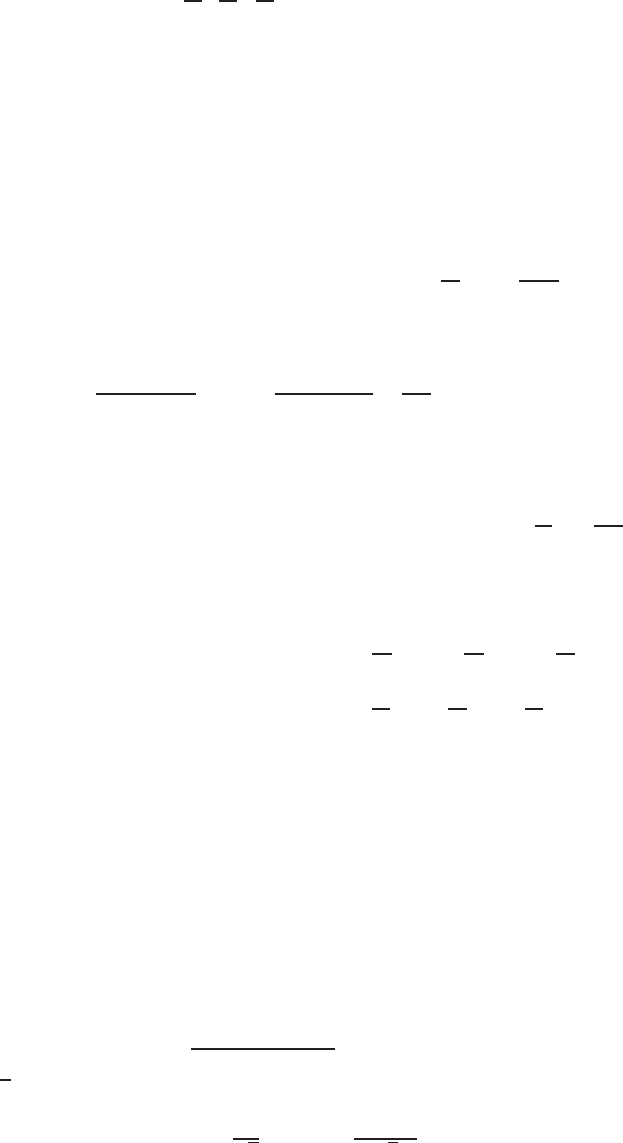
SOLUTIONS to Review Problems for Chapter Twenty 1831
Job: chap20-sols Sheet: 33 Page: 1831 (August 24, 2012 11 : 19) [ex-misc]
(b) Not defined; we cannot integrate a vector field over a solid region in space.
(c) Since
curl ~
F=
~
i~
j~
k
∂
∂x
∂
∂y
∂
∂z
x3y3z3
=~
0,
we have RScurl ~
F·d~
A= 0.
(d) Not defined; we cannot calculate the gradient of a vector field.
(e) Since
div ~
F= div(x3
~
i+y3~
j+z3~
k) = 3x2+ 3y2+ 3z2,
we have ZW
div ~
F dV = 3 ZW
(x2+y2+z2)dV.
Converting to spherical coordinates gives
ZW
div ~
F dV = 3 Z2π
0Zπ
0Z2
0
ρ2ρ2sin φ dρ dφ dθ = 3 ·2π−cos φ
π
0 ρ5
5
2
0!=384π
5.
(f) Since ~
F= grad((x4+y4+z4)/4), we use the Fundamental Theorem of Line Integrals to get
ZC
~
F·d~r =x4+y4+z4
4
(2,3,4)
(0,0,0)
=24+ 34+ 44
4=353
4.
Alternatively, we parameterize the line by x= 2t, y = 3t, z = 4tfor 0≤t≤1. Then on the line ~
F=
8t3
~
i+ 27t3~
j+ 64t3~
kand r′(t) = 2
~
i+ 3~
j+ 4~
k, giving
ZC
~
F·d~r =Z1
0
(8t3
~
i+27t3~
j+64t3~
k)·(2
~
i+3~
j+4~
k)dt =Z1
0
(16t3+81t3+256t3)dt = 353 t4
4
1
0
=353
4.
(g) Not defined; curl ~
Fis a vector field and we cannot integrate a vector field over a solid region in space.
(h) We have ~
F=x3
~
i+y3~
j+z3~
kso
ZW
~
F·(
~
i+~
j+~
k)dV=Z3
0Z2
0Z1
0
(x3+y3+z3)dx dy dz = 2 ·3x4
4
1
0
+ 1 ·3y4
4
2
0
+ 1 ·2z4
4
3
0
= 2 ·314
4+ 1 ·324
4+ 1 ·234
4= 54.
26. (a) Defined; equal to (e) and (f) by Stokes’ Theorem.
(b) Not defined.
(c) Not defined.
(d) Defined; not equal to others in list.
(e) Defined; equal to (a) and (f) by Stokes’ Theorem.
(f) Defined; equal to (a) and (e) by Stokes’ Theorem.
(g) Defined; not equal to others in list.
27. (a) At P, we have curl ~
F= 6
~
i+ 5~
j−8~
k, so
curl ~
F·(
~
i+~
j+~
k) = 6 + 5 −8 = 3.
(b) The definition of the curl tells us that if ~n is the unit vector normal to the plane containing the circle and pointing
away from the origin, then
curl ~
F·~n ≈RC~
F·d~r
Area enclosed by C.
Since ~n = (
~
i+~
j+~
k)/√3, we have
ZC
~
F·d~r ≈(curl ~
F·~n )Area of circle =3
√3π(0.01)2=0.0003π
√3= 0.000544.

1832 Chapter Twenty /SOLUTIONS
Job: chap20-sols Sheet: 34 Page: 1832 (August 24, 2012 11 : 19) [ex-misc]
28. .
The vector curl ~
Ghas its component in the x-direction given by
(curl ~
G)x≈Circulation around small square around x-axis
Area inside square
=Circulation around S2
Area inside S2
=6
(0.1)2= 600.
Similar reasoning leads to
(curl ~
G)y≈Circulation around S3
Area inside S3
=−5
(0.1)2=−500.
(curl ~
G)z≈Circulation around S1
Area inside S1
=−0.02
(0.1)2=−2.
Thus,
curl ~
G≈600
~
i−500~
j−2~
k .
29. (a) It appears that div ~
F < 0, and div ~
G < 0;div ~
Gis larger in magnitude (more negative) if the scales are the same.
(b) curl ~
Fand curl ~
Gboth appear to be zero at the origin (and elsewhere).
(c) Yes, the cylinder with axis along the z-axis will have negative flux through it (ends parallel to xy-plane).
(d) Same as part(c).
(e) No, you cannot draw a closed curve around the origin such that ~
Fhas a non-zero circulation around it because curl
is zero. By Stokes’ theorem, circulation equals the integral of the curl over the surface bounded by the curve.
(f) Same as part(e)
30. (a) Since the disk is in the plane z=√5, only the ~
kcomponent of ~
Fcontributes to the integral. Since the disk is
oriented downward, d~
A=−~
k dA on the disk; in addition, z=√5on the disk. Thus,
ZS
~
F·d~
A=ZS
(√5~
k)·(−~
k dA) = −√5·Area of disk =−√5π(√10)2=−10√5π.
(b) The line is parallel to the x-axis, so only the ~
icomponent of ~
Fcontributes to the integral. Since d~r =~
i dx and
y=√3on the line, ZC
~
F·d~r =ZC
(√3
~
i)·(
~
i dx) = √3·Length of line = 2√3.
(c) Using Stokes’ Theorem, if Cis the boundary of Swith induced orientation,
ZS
curl ~
F·d~
A=ZC
~
F·d~r .
The boundary of the rectangle Chas four parts. The orientation is counterclockwise when viewed from above. The
integral along the x-axis is 0because the~
icomponent is 0there. Similarly, the integral along the y-axis is 0because
the ~
jcomponent is 0there.
The integral along the top of the rectangle uses the reverse orientation to the answer to part (b), so its value is
−2√3. The integral along the right side depends only on the ~
jcomponent at x= 2, so the value is of this integral is
π·2·Length of line = 2√3π. Thus,
ZS
curl ~
F·d~
A=ZC
~
F·d~r = 0 + 0 −2√3 + 2√3π= 2√3(π−1).
Alternatively, direct calculations gives
curl F=
~
i~
j~
k
∂
∂x
∂
∂y
∂
∂z
y πx z
= (π−1)~
k .
Thus, ZS
curl ~
F·d~
A=ZS
(π−1)~
k·~
k dA = (π−1) ·Area of S= 2√3(π−1).
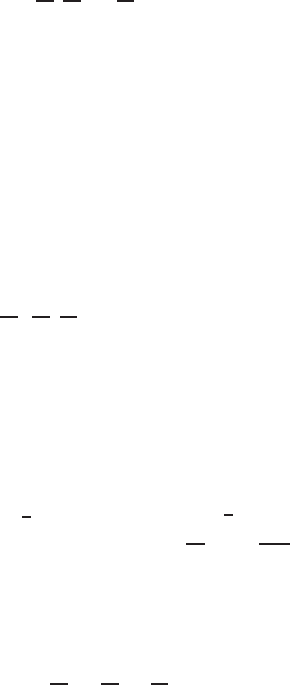
SOLUTIONS to Review Problems for Chapter Twenty 1833
Job: chap20-sols Sheet: 35 Page: 1833 (August 24, 2012 11 : 19) [ex-misc]
31. We calculate
curl x2
~
i+y2~
j+(x+y+z)~
k=
~
i~
j~
k
∂
∂x
∂
∂y
∂
∂z
x2y2x+y+z
=~
i−~
j ,
and use Stokes’ Theorem with Das the surface (x−1)2+ (y−2)2≤4in the xy-plane, oriented in the positive
z-direction: ZCx2
~
i+y2~
j+(x+y+z)~
k·d~r =ZD
(
~
i−~
j)·d~
A .
Since d~
A=~
k dA, we have ZD
(
~
i−~
j)·d~
A=ZD
0dA = 0.
32. We use Stokes’ Theorem. We have
curl(−y3
~
i+x3~
j+ez~
k) =
~
i~
j~
k
∂
∂x
∂
∂y
∂
∂z
−y3x3ez
= (3x2+ 3y2)~
k .
So if Dis the disk x2+y2≤3,z= 4, oriented upward, we have
ZC
(−y3
~
i+x3~
j+ez~
k)·d~r =ZD
(3x2+ 3y2)~
k·d~
A= 3 ZD
(x2+y2)dA.
Converting to polar coordinates, we have
ZC
(−y3
~
i+x3~
j+ez~
k)·d~r = 3 Z2π
0Z√3
0
r2·r dr dθ = 3 ·2πr4
4
√3
0
=27π
2.
33. We calculate
curl sin x2
~
i+cos y2~
j+ (x+y)~
k=
~
i~
j~
k
∂
∂x
∂
∂y
∂
∂z
sin x2cos y2x+y
=~
i−~
j ,
and use Stokes’ Theorem with Das the surface (y−1)2+ (z−2)2≤4in the yz-plane, oriented in the positive
x-direction: ZCsin x2
~
i+cos y2~
j+ (x+y)~
k·d~r =ZD
(
~
i−~
j)·d~
A .
Since d~
A=~
i dA, we have
ZD
(
~
i−~
j)·d~
A=ZD
1dA=Area D=π22= 4π.
34. We use Stokes’ Theorem. If Cis the circle y2+z2= 3,oriented counterclockwise when viewed from the positive
x-direction, then Stokes’ Theorem gives
ZS
curl ~
F·d~
A=ZC
~
F·d~r =ZC(z+y)
~
i−(z+x)~
j+ (y+x)~
k·d~r .
Since Cis in the yz-plane, the~
icomponent does not contribute to the line integral. On the yz-plane, x= 0 so
ZS
curl ~
F·d~
A=ZC
~
F·d~r =ZC
(−z~
j+y~
k)·d~r .
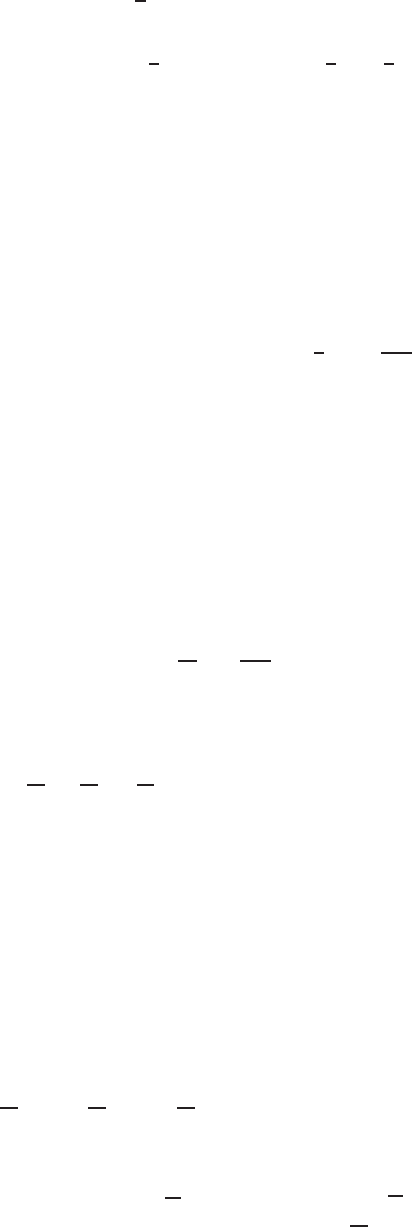
1834 Chapter Twenty /SOLUTIONS
Job: chap20-sols Sheet: 36 Page: 1834 (August 24, 2012 11 : 19) [ex-misc]
On the circle y2+z2= 3,we have
−z~
j+y~
k
=√3and −z~
j+y~
kis tangent to the curve pointing in the
counterclockwise direction, so
ZS
curl ~
F·d~
A=ZC
(−z~
j+y~
k)·d~r =√3·Length of curve =√3·2π√3 = 6π.
35. Since
div(3x
~
i+ 4y~
j+xy~
k) = 3 + 4 + 0 = 7,
we calculate the flux using the Divergence Theorem:
Flux =ZS
(3x
~
i+ 4y~
j+xy~
k)·d~
A=ZW
7dV = 7 ·Volume of box = 7 ·3·5·2 = 210.
36. We use the Divergence Theorem.
Since div ~
F= 3 −1 + 2 = 4 and a closed surface is oriented outward, the Divergence Theorem gives
ZS
~
F·d~
A=ZInterior
of sphere
div ~
F dV = 4 ·Volume of sphere = 4 ·4
3π13=16π
3.
37. We use the Divergence Theorem. Since div ~
F= 3x2+3y2+3z2and a closed surface is oriented outward, the Divergence
Theorem gives
ZS
~
F·d~
A=ZInterior
of sphere
div ~
F dV
=ZInterior
of sphere 3x2+ 3y2+ 3z2dV
= 3 Z2π
0Zπ
0Z1
0
ρ2·ρ2sin φ dρ dφ dθ
= 3 ·2π(−cos φ)
π
0
ρ5
5
1
0
=12π
5.
38. We use Stokes’ Theorem. Since
curl ~
F=
~
i~
j~
k
∂
∂x
∂
∂y
∂
∂z
x+y y + 2z z + 3x
=−2
~
i−3~
j−~
k ,
if Sis the interior of the square, then
ZC
~
F·d~r =ZS
curl ~
F·d~
A=ZS
(−2
~
i−3~
j−~
k)·d~
A
Since the area vector of Sis 49~
j, we have
ZC
~
F·d~r =ZS
(−2
~
i−3~
j−~
k)·d~
A=−3~
j·49~
j=−147.
39. We use Stokes’ Theorem. Since
curl ~
F=
~
i~
j~
k
∂
∂x
∂
∂y
∂
∂z
x−y3+z x3+y+z x +y+z3
= (3x2+ 3y2)~
k ,
if Sis the disk x2+y2≤10 oriented upward,
ZC
~
F·d~r =ZS
(3x2+ 3y2)~
k·d~
A= 3 Z2π
0Z√10
0
r2·r dr dθ = 3 ·2π·r4
4
√10
0
= 150π.
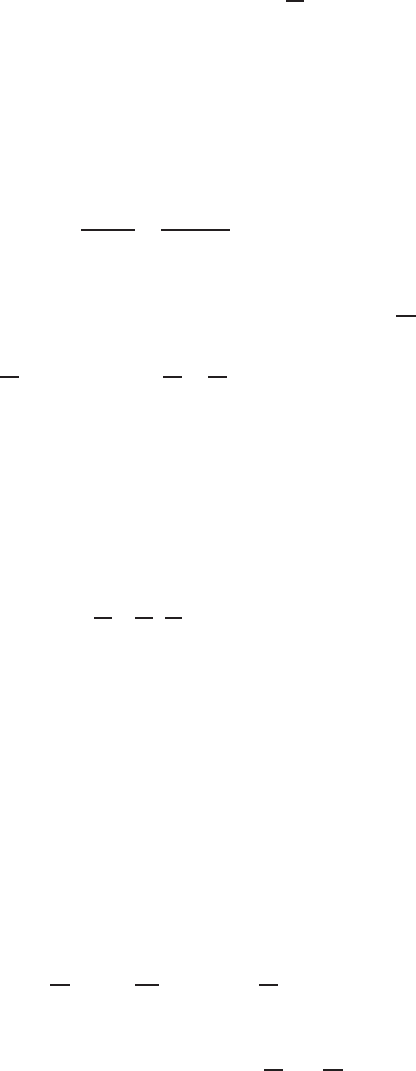
SOLUTIONS to Review Problems for Chapter Twenty 1835
Job: chap20-sols Sheet: 37 Page: 1835 (August 24, 2012 11 : 19) [ex-misc]
40. We use the Divergence Theorem. Since div ~
F= 3y2+ 3z2,we have
ZS
~
F·d~
A=ZInterior
of cylinder
(3y2+ 3z2)dV.
Converting to cylindrical coordinates with y=rcos θ, z =rsin θ, we have y2+z2=r2,so
ZS
~
F·d~
A=3Z1
−1Z2π
0Z4
0
r2·rdr dθ dx = 3 ·2·2πr4
4
4
0
=768π.
41. We use the fact that if S1and S2are surfaces which share a common boundary C, and if S1and S2determine the same
orientation of C, then ZS1
curl ~
F·d~
A=ZS2
curl ~
F·d~
A.
We replace the surface Sby S0, the base of the cube, oriented upward because S0is easier to integrate over. (Both
surfaces have the unit square in the xy-plane as the boundary.) Since S0is horizontal, we need only find the ~
kcomponent
of curl ~
F:
z-component of curl ~
F=∂(yex)
∂x −∂(−xey)
∂y = (yex+xey)~
k .
Thus, we have
ZS
curl ~
F·d~
A=ZS0
(yex+xey)dA =Z1
0Z1
0
(yex+xey)dxdy =Z1
0
yex+x2
2ey
1
0
dy
=Z1
0
(ey +ey
2−y)dy = (e−1) y2
2+ey
2
1
0
=e−1.
42. Let Sbe the disk inside the unit circle, oriented upward. By Stokes’ Theorem,
ZC
~
F·d~r =ZS
4~
k·d~
A= 4 ·Area of disk = 4 ·π12= 4π.
43. (a) Let Dbe the face of the box which was removed from the yz-plane. We use Stokes’ Theorem with Das the surface.
curl ~
F=
~
i~
j~
k
∂
∂x
∂
∂y
∂
∂z
x+y−z y
= 2
~
i−2~
k ,
so ZC
~
F·d~r =ZD
curl ~
F·d~
A=ZD
(2
~
i−2~
k)·d~
A= 2(Area of D) = 2 ·32= 18.
(b) To use the Divergence Theorem, we calculate that div ~
F= 1. Since the Divergence Theorem requires a closed
surface, we close Sby adding D, oriented in the direction of the negative x-axis. Then
ZS+D
~
F·d~
A=ZS
~
F·d~
A+ZD
~
F·d~
A=ZInterior
1dv=Volume of box = 27.
Now on D, where x= 0, we have ~
F=y~
i−z~
j+y~
k. In addition, on D, we have d~
A=−~
i dy dz, so
ZD
~
F·d~
A=Z(y~
i−z~
j+y~
k)·(−i dy dz) = −Z3
0Z3
0
y dy dz
=−Z3
0
y2
2
3
0
dz =−9
2Z3
0
dz =−27
2.
Thus, ZS
~
F·d~
A=27 −ZD
~
F·d~
A=27 −−27
2=81
2.
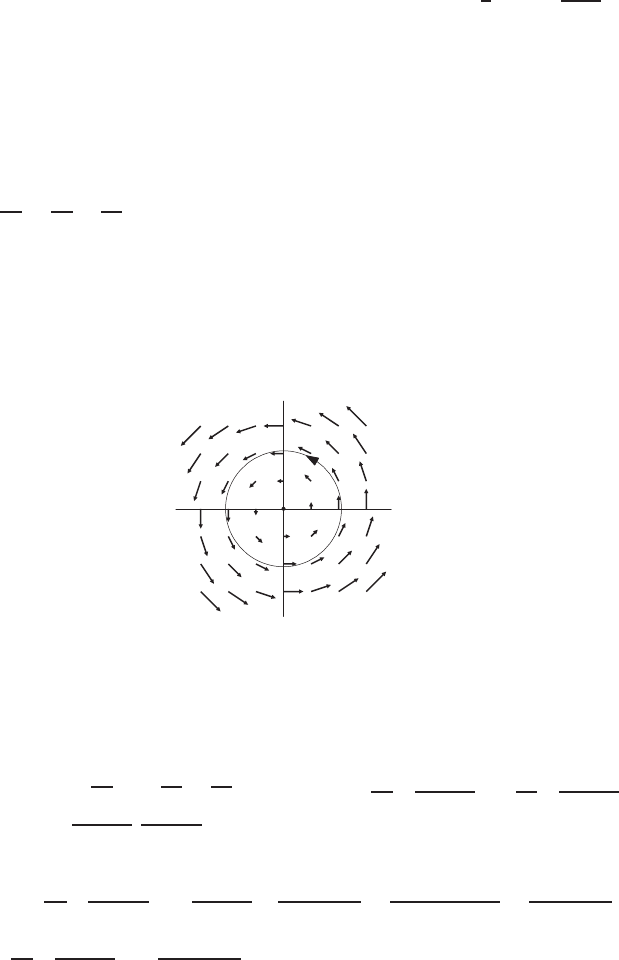
1836 Chapter Twenty /SOLUTIONS
Job: chap20-sols Sheet: 38 Page: 1836 (August 24, 2012 11 : 19) [ex-misc]
44. (a) Can be computed. If Wis the interior of the sphere, by the Divergence Theorem, we have
ZS
~
F·d~
A=ZW
div ~
F dV = 4 ·Volume of sphere = 4 ·4
3π·23=128π
3.
(b) Cannot be computed.
(c) Can be computed. Use the fact that div(curl ~
F) = 0.If Wis the inside of the sphere, then by the Divergence
Theorem, ZS
curl ~
F·d~
A=ZW
div(curl ~
F)dV =ZW
0dV = 0
45. (a) curl ~
F=
~
i~
j~
k
∂
∂x
∂
∂y
∂
∂z
y2z2xyz xy
= (x−2xy)
~
i−(y−y2)~
j+ (2yz −2yz)~
k6=~
0. Since curl ~
F6= 0, we know ~
F
is not conservative.
(b) A line integral round the closed path shown in Figure 20.9 is not zero, so ~
Fis not conservative.
Note: To show that a vector field is not conservative, we only need to find one path whose line integral is nonzero.
To show that a vector field is conservative, we must show the line integral is zero on all paths.
x
y
Figure 20.9
46. (a) We have
curl ~
F=
~
i~
j~
k
∂
∂x
∂
∂y
∂
∂z
−y
x2+y2
x
x2+y20
= 0
~
i+ 0~
j+∂
∂x x
x2+y2+∂
∂y y
x2+y2~
k .
Since
∂
∂x x
x2+y2=1
x2+y2−x(2x)
(x2+y2)2=x2+y2−2x2
(x2+y2)2=y2−x2
(x2+y2)2
and similarly ∂
∂y y
x2+y2=x2−y2
(x2+y2)2, we have, provided x2+y26= 0,
curl ~
F=~
0.
The domain of curl ~
Fis all points in 3-space except the z-axis.
(b) On C1, the unit circle x2+y2= 1 in the xy-plane, the vector field ~
Fis tangent to the circle and ||~
F|| = 1. Thus
Circulation =ZC1
~
F·d~r =||~
F|| · Perimeter of circle = 2π.
Note that Stokes’ Theorem cannot be used to calculate this circulation since the z-axis pierces any surface which has
this circle as boundary.
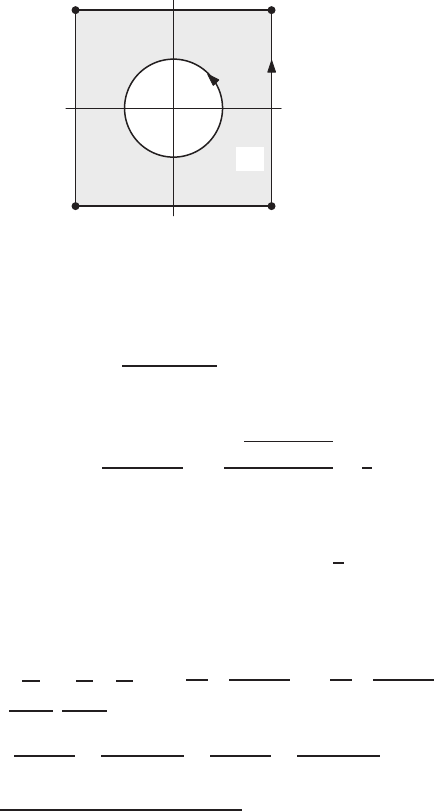
SOLUTIONS to Review Problems for Chapter Twenty 1837
Job: chap20-sols Sheet: 39 Page: 1837 (August 24, 2012 11 : 19) [ex-misc]
(c) Consider the disk (x−3)2+y2≤1in the plane z= 4. This disk has C2as boundary and curl ~
F=~
0everywhere
on this disk. Thus, by Stokes’ Theorem RC2
~
F·d~r = 0.
(d) The square Shas an interior region which is pierced by the z-axis, so we cannot use Stokes’ Theorem. We consider
the region, D, between the circle C1and the square S. See Figure 20.10. Stokes’ Theorem applies to the region D,
provided C1is oriented clockwise. Then we have
ZC1(clockwise)
~
F·d~r +ZS
~
F·d~r =ZD
curl ~
F·d~
A= 0.
Thus, ZS
~
F·d~r =−ZC1(clockwise)
~
F·d~r =ZC1(counterclockwise)
~
F·d~r = 2π.
(e) If a simple closed curve goes around the z-axis, then it contains a circle Cof the form x2+y2=a2. The circulation
around Cis 2πor −2π, depending on its orientation. A calculation similar to that in part (d) then shows that the
circulation around the curve is 2πor −2π, again depending on its orientation. If the closed curve does not go around
the z-axis, then curl ~
F=~
0everywhere on its interior and the circulation is zero.
(2,2,0)(−2,2,0)
(−2,−2,0) (2,−2,0)
C1
S
D
x
y
Figure 20.10
47. (a) Notice that ~
Fis tangent to the circle, because
~
F·~r =(−y~
i+x~
j)
x2+y2·(x
~
i+y~
j) = 0,
and ~
Fhas constant magnitude on the circle x2+y2= 9, since
||~
F|| =−y~
i+x~
j
x2+y2=p(−y)2+x2
x2+y2=1
3.
Thus, the line integral can be calculated as follows:
ZC1
~
F·d~r =||~
F|| · Circumference of circle =1
3·2π3 = 2π.
(b) We have
curl ~
F=
~
i~
j~
k
∂
∂x
∂
∂y
∂
∂z
−y
x2+y2
x
x2+y20
=∂
∂x x
x2+y2−∂
∂y −y
x2+y2~
k
=1
x2+y2−2x2
(x2+y2)2+1
x2+y2−2y2
(x2+y2)2~
k
=x2+y2−2x2+x2+y2−2y2
(x2+y2)2~
k=~
0.
Thus, curl ~
F=~
0except where x=y= 0, on the z-axis, where it is not defined.
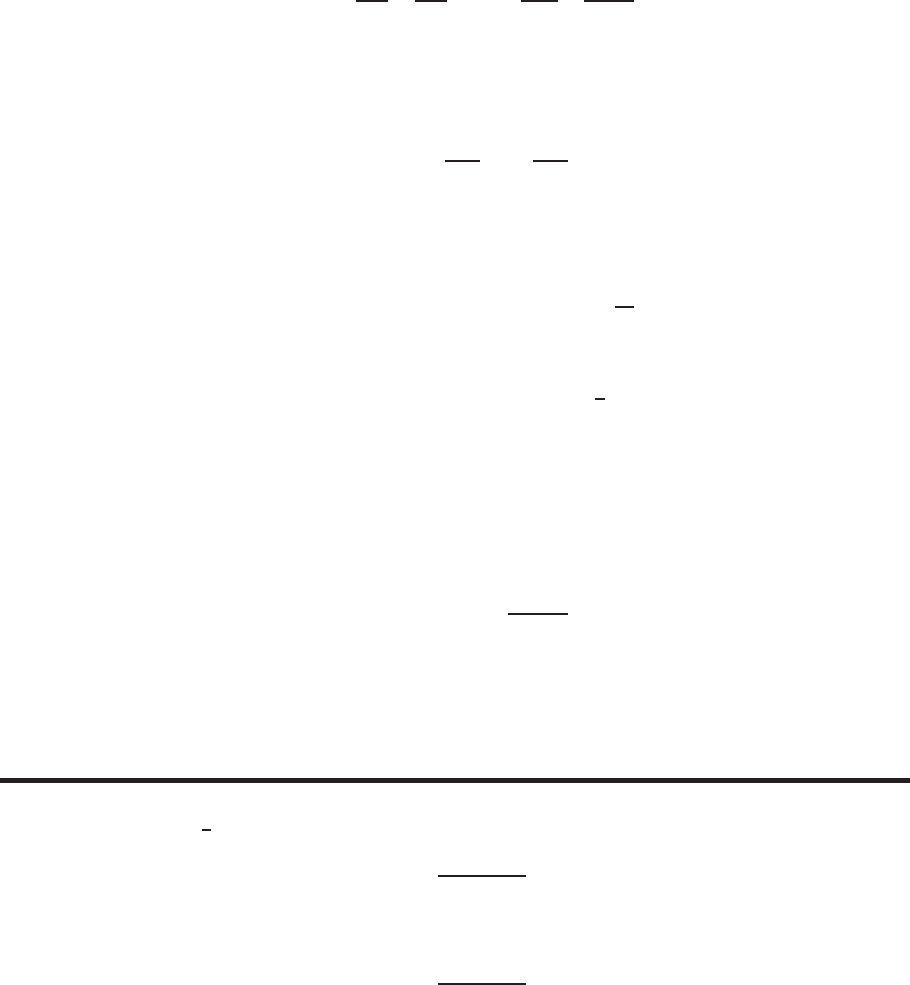
1838 Chapter Twenty /SOLUTIONS
Job: chap20-sols Sheet: 40 Page: 1838 (August 24, 2012 11 : 19) [ex-misc]
(c) Stokes’ Theorem cannot be used to calculate RC1because the z-axis cuts any surface whose boundary is C1.
(d) Since the disk D2inside C2does not intersect the z-axis, Stokes’ Theorem can be used:
ZC2
~
F·d~r =ZD2
curl ~
F·d~
A=ZD2
~
0·d~
A= 0.
(e) The vector field ~
Fis not a gradient field since RC1
~
F·d~r 6= 0.
48. Note that planes of the form mx +ny =dare vertical, so their normals have no ~
kcomponent.
(a) Since
curl ~
F=∂F2
∂x −∂F1
∂y ~
k=∂(x)
∂x −∂(−y)
∂y ~
k= 2~
k ,
by Stokes’ Theorem, the circulation around curves in the xy-plane and the plane x+y+z= 0 can be nonzero. The
circulation is 0 for (II), (III), (V).
(b) Since ~
G= grad(xy), the circulation around any closed curve is 0. So the circulation is 0 around (I), (II), (III), (IV),
(V).
(c) Since
curl ~
H=−∂H2
∂z ~
i=−∂(z)
∂z ~
i=−~
i ,
the circulation can be nonzero around any curve in a plane whose normal has a nonzero~
icomponent. The circulation
is 0 for (I), (III).
49. (a) Only the ~
k-component of ~
Fcontributes to the line integral, so
ZC
~
F·d~r =Z10
0
z~
k·~
k dz =Z10
0
z dz =z2
2
10
0
= 50.
(b) Only the ~
kcomponent of ~
Fcontributes to the flux integral; this component is 10~
k. Thus,
ZS
~
F·d~
S=10 ·Area of S= 10π(√3)2= 30π.
(c) We use the Divergence Theorem, with div ~
F= 1. Thus, if Wis the region inside the box,
ZS
~
F·d~
A=ZW
1dV= 1 ·Volume of box = 23= 8.
(d) Only the~
iand ~
jcomponents contribute to the line integral. The horizontal component of the vector field, y~
i−x~
j,
is tangent to the circle, and points in the clockwise direction. On C, the length of the horizontal component is
||y~
i−x~
j|| =py2+x2= 3.
Thus, ZC
~
F·d~r =−3·Circumference of circle =−3·2π3 = −18π.
CAS Challenge Problems
50. (a) curl ~
F(1,2,1) = −6
~
i−8~
j+~
k .
(b) RCa
~
F·d~r =−3
2(4a2+a4)π.
lim
a→0RCa
~
F·d~r
πa2=−6.
This is the~
icomponent of curl ~
F(1,2,1) according to the circulation density formula.
(c) RDa
~
F·d~r =−8a2π.
lim
a→0RCa
~
F·d~r
πa2=−8.
This is the ~
jcomponent of curl ~
F(1,2,1).

PROJECTS FOR CHAPTER TWENTY 1839
Job: chap20-sols Sheet: 41 Page: 1839 (August 24, 2012 11 : 19) [ex-project]
(d) REa
~
F·d~r =−1
4(−4a2+ 3a4)π.
lim
a→0RCa
~
F·d~r
πa2= 1.
This is the ~
kcomponent of curl ~
F(1,2,1).
(e) The curves Caare circles of radius aaround the point (1,2,1) facing in the positive x-direction, so the limit as a→0
of the circulation around them is the ~
i-component of the curl, according to the geometric definition. Similarly, the
curves Daare circles facing in the y-direction and the curves Eaare circles facing in the z-direction, so they give the
~
jand ~
kcomponents of the curl.
51. (a) Let Wbe the region enclosed by the sphere. We have div ~
F= 2ax+bz +2cy+p+qso by the Divergence Theorem
RS~
F·d~
A=RW(2ax+bz+2cy+p+q)dV . Now RWx dV =RWy dV =RWz dV = 0, because Wis symmetric
about the origin and x,y, and zare odd functions. So RW(2ax+bz +2cy+p+q)dV =RB(p+q)dV =4(p+q)πR3
3.
(b) Using spherical coordinates, we calculate the flux integral directly as
Z2π
0Zπ
0
((bR2cos(θ) cos(φ) sin(φ) + aR2cos(θ)2sin(φ)2)
~
i
+(pR sin(θ) sin(φ) + cR2sin(θ)2sin(φ)2)~
j+ (qR cos(φ)
+rR3cos(θ)3sin(φ)3)~
k)·(sin φcos θ
~
i+ sin φsin θ~
j+ cos φ~
k)R2sin φ dφdθ =4(p+q)πR3
3.
Rather than entering this integral directly into your CAS, it is better to define the vector field and parameterization
separately and enter the formula for flux integral through a sphere.
52. (a) div ~
F(1,1,1) = 5.
(b) On a small sphere centered at (1,1,1) the divergence is approximately constant and equal to its value at (1,1,1),
namely 5. Geometrically the divergence is the flux density, so the total flux is approximately the divergence multiplied
by the volume, so RS~
F·d~
A≈5(volume of S) = 20
3π(0.1)3≈0.02094...
(c) The area element on the sphere is d~
A= (sin φcos θ
~
i+ sin φsin θ~
j+ cos φ~
k)a2sin φ dφdθ. Using a CAS to
calculate the flux integral we get RS~
F·d~
A= (20πa3/3) + (4πa5/5), which is .02097 when a=.1. This is close
to the approximation we found in part (b). The limit
lim
a→0RSa
~
F·d~
A
Volume inside Sa
= lim
a→0
(20πa3/3) + (4πa5/5)
(4/3)πa3= lim
a→0(5 + 3a2
5) = 5.
This agrees with the value of the divergence we found in part (a). This makes sense, because the limit is just the
geometric definition of divergence.
PROJECTS FOR CHAPTER TWENTY
1. (a) Since Sdoes not touch the wire, it is in a region of space where there is no current. Hence curl ~
B=~
0at
every point of S. Therefore, ZS
curl ~
B·d~
A= 0.
The flux of curl ~
Bthrough Sis 0.
(b) The boundary of Sis a curve, C, in two pieces, C1and C2. Given the upward orientation of S,the curve
C1is oriented clockwise and C2is oriented counterclockwise when viewed from above. (See Figure 20.26
in the text.)
The vector field has constant magnitude on each circle and is parallel to the circle. Therefore,
ZC2
~
B·d~r =k~
B(P2)k · Length of C2= 2πR2k~
B(P2)k.
Because C1is oriented in the opposite direction
ZC1
~
B·d~r =−k~
B(P1)k·Length of C1=−2πR1k~
B(P1)k.

1840 Chapter Twenty /SOLUTIONS
Job: chap20-sols Sheet: 42 Page: 1840 (August 24, 2012 11 : 19) [ex-project]
(c) From Stokes’ Theorem, ZS
curl ~
B·d~
A=ZC
~
B·d~r .
Since ZS
curl ~
B·d~
A= 0
and ZC
~
B·d~r =ZC1
~
B·d~r +ZC2
~
B·d~r
we have ZC2
~
B·d~r =−ZC1
~
B·d~r .
Hence,
2πR2k~
B(P2)k=−(−2πR1k~
B(P1)k)
and thus
k~
B(P2)k= (R1k~
B(P1)k)1
R2
.
Letting k=R1k~
B(P1)kbe constant and thinking of R2=ras a variable, we have
k~
B(P2)k=k1
r.
This relationship shows that k~
B(P2)kis proportional to the reciprocal of the distance rfrom P2to the
wire.
(d) If the distance from Pto the wire is r, then the distance from Qto the wire is 2r. Using the proportionality
in part (c), we have
k~
B(P)k=k
r
and
k~
B(Q)k=k
2r=1
2k~
B(P)k.
Doubling the distance from the wire cuts the magnitude of ~
Bin half.
(e) Suppose the distance from Pto the wire is r, so that
k~
B(P)k=k
r.
If the distance from Qto the wire is Rand if k~
B(Q)k= 0.8k~
B(P)k, then
k~
B(Q)k=k
R= 0.8k
r.
Solving gives
R=r
0.8= 1.25r,
so the distance from the wire must be increased by 25%.

PROJECTS FOR CHAPTER TWENTY 1841
Job: chap20-sols Sheet: 43 Page: 1841 (August 24, 2012 11 : 19) [chap20-sols]
2. First compute the unit vectors ~
Tand ~
N. Since ~
Tis in the direction of ~
Fwe have
~
T=1
k~
Fk
~
F=1
F(u
~
i+v~
j).
Since ~
Nis the unit vector in the direction of ~
k×~
Fwe have
~
k×~
F=~
k×(u
~
i+v~
j)
=−v~
i+u~
j
~
N=1
k − v~
i+u~
jk(−v~
i+u~
j)
=1
F(−v~
i+u~
j).
The chain rule for partial differentiation of the formulas u=Fcos θand v=Fsin θgives
uy= (cos θ)Fy−F(sin θ)θy
vx= (sin θ)Fx+F(cos θ)θx.
Since, for a 2-dimensional vector field, curl ~
F= (vx−uy)~
kwe have
c=vx−uy
= ((sin θ)Fx+F(cos θ)θx)−((cos θ)Fy−F(sin θ)θy)
= (uθx+vθy) + 1
F(vFx−uFy)
= (θx
~
i+θy~
j)·(u
~
i+v~
j)−1
F(Fx
~
i+Fy~
j)·(−v~
i+u~
j)
=Fgrad θ·~
T−grad F·~
N .
Since the directional derivative of θin the direction of ~
Tis θ~
T= grad θ·~
Tand the directional derivative
of Fin the direction of ~
Nis F~
N= grad F·~
Nwe have
c=F θ~
T−F~
N.
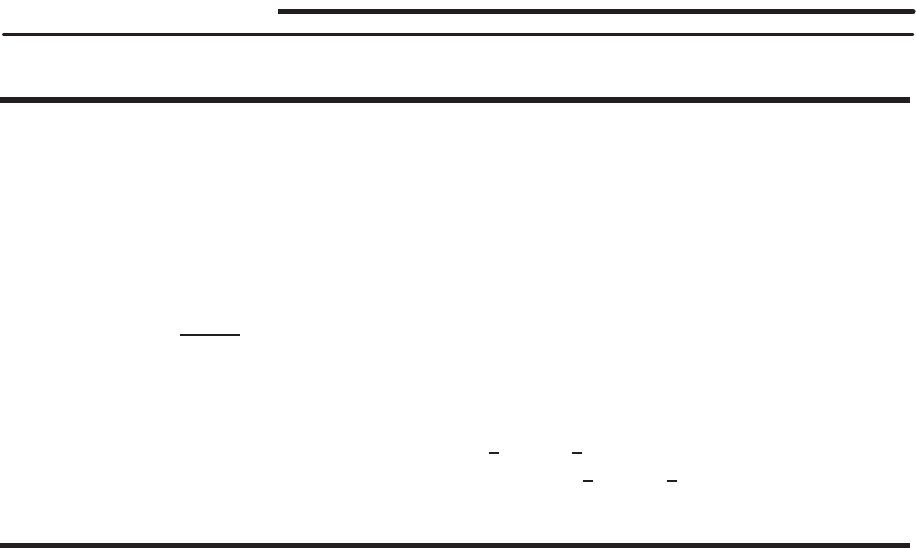
21.1 SOLUTIONS 1843
CHAPTER TWENTY-ONE
Solutions for Section 21.1
Exercises
1. There is just one parameter, s, so the parameterization describes a curve.
2. There are two parameters, sand t, so the parameterization describes a surface.
3. There are two parameters, sand t, so the parameterization describes a surface.
4. There is just one parameter, s, so the parameterization describes a curve.
5. A horizontal disk of radius 5in the plane z= 7.
6. A cylinder of radius 5centered around the z-axis and stretching around from z= 0 to z= 7.
7. A helix (curve) of radius 5which makes one turn about the z-axis, starting at the point (5,0,0) and ending at the point
(5,0,10π).
8. Since z=r=px2+y2, we have a cone around the z-axis. Since 0≤r≤5, we have 0≤z≤5, so the cone has
height and maximum radius of 5.
9. The top half of the sphere (z≥0).
10. The half of the sphere with y≤0.
11. A vertical segment lying between two longitudinal lines (θ=π
4and θ=π
3) and stretching between the poles.
12. Half the horizontal ring around the sphere between two latitude lines (φ=π
4and φ=π
3) in the northern hemisphere.
Problems
13. Two vectors in the plane containing P= (0,0,0),Q= (1,2,3), and R= (2,1,0) are the displacement vectors
~v 1=~
P Q =~
i+ 2~
j+ 3~
k
~v 2=~
P R = 2
~
i+~
j .
Letting ~r 0= 0
~
i+ 0~
j+ 0~
k=~
0we have the parameterization
~r (s, t) = ~r 0+s~v 1+t~v 2
= (s+ 2t)
~
i+ (2s+t)~
j+ 3s~
k .
14. Two vectors in the plane containing P= (1,2,3),Q= (2,5,8), and R= (5,2,0) are the displacement vectors
~v 1=~
P Q =~
i+ 3~
j+ 5~
k
~v 2=~
P R = 4
~
i−3~
k .
Letting ~r 0=~
i+ 2~
j+ 3~
kwe have the parameterization
~r (s, t) = ~r 0+s~v 1+t~v 2
= (1 + s+ 4t)
~
i+ (2 + 3s)~
j+ (3 + 5s−3t)~
k .
15. To parameterize the plane we need two nonparallel vectors ~v 1and ~v 2that are parallel to the plane. Such vectors are
perpendicular to the normal vector to the plane, ~n =~
i+~
j+~
k. We can choose any vectors ~v 1and ~v 2such that
~v 1·~n =~v 2·~n = 0.
One choice is
~v 1=~
i−j ~v 2=~
i−~
k .
Letting ~r 0= 3
~
i+ 5~
j+ 7~
kwe have the parameterization
~r (s, t) = ~r 0+s~v 1+t~v 2
= (3 + s+t)
~
i+ (5 −s)~
j+ (7 −t)~
k .
1844 Chapter Twenty-One /SOLUTIONS
16. To parameterize the plane we need two nonparallel vectors ~v 1and ~v 2that are parallel to the plane. Such vectors are
perpendicular to the normal vector to the plane, ~n =~
i+ 2~
j+ 3~
k. We can choose any vectors ~v 1and ~v 2such that
~v 1·~n =~v 2·~n = 0.
One choice is
~v 1= 2
~
i−j ~v 2= 3
~
i−~
k .
Letting ~r 0= 5
~
i+~
j+ 4~
kwe have the parameterization
~r (s, t) = ~r 0+s~v 1+t~v 2
= (5 + 2s+ 3t)
~
i+ (1 −s)~
j+ (4 −t)~
k .
17. (a) We want to find sand tso that
2 + s= 4
3 + s+t= 8
4t= 12
Since s= 2 and t= 3 satisfy these equations, the point (4,8,12) lies on this plane.
(b) Are there values of sand tcorresponding to the point (1,2,3)? If so, then
1 = 2 + s
2 = 3 + s+t
3 = 4t
From the first equation we must have s=−1and from the third we must have t= 3/4. But these values of sand t
do not satisfy the second equation. Therefore, no value of sand tcorresponds to the point (1,2,3), and so (1,2,3)
is not on the plane.
18. If the planes are parallel, then their normal vectors will also be parallel. The equation of the first plane can be written
~r = 2
~
i+ 4~
j+~
k+s(
~
i+~
j+ 2~
k) + t(
~
i−~
j).
A normal vector to the first plane is ~n 1= (
~
i+~
j+ 2~
k)×(
~
i−~
j) = 2
~
i+ 2~
j−2~
k . The second plane can be written
~r = 2
~
i+s(
~
i+~
k) + t(2
~
i+~
j−~
k).
A normal vector to the second plane is ~n 2= (
~
i+~
k)×(2
~
i+~
j−~
k) = −~
i+ 3~
j+~
k. Since ~n 1and ~n 2are not
parallel, neither are the two planes.
19. The surface is the plane z= 1. The family of parameter curves with sconstant and tvarying consists of lines in the plane
parallel to the y-axis. The family with tconstant and svarying consists of lines in the plane parallel to the x-axis.
20. The surface is the cylinder of radius 1 centered on the x-axis with equation y2+z2= 1. The family of parameter curves
with sconstant and tvarying consists of circles on the cylinder, the cross-sections of the cylinder parallel to the yz-plane.
The family with tconstant and svarying consists of lines on the cylinder parallel to the x-axis.
21. The surface is the graph of the equation z=x2+y2, a parabola. The family of parameter curves with sconstant and t
varying consists of cross-sections of the graph with xfixed. If s=s0, the cross-section has equation z=s2
0+y2in the
plane x=s0, so it is a parabola. The family of parameter curves with tconstant and svarying consists of cross-sections
of the graph with yfixed. If t=t0, the cross-section has equation z=x2+t2
0in the plane y=t0, so it is a parabola.
22. The parametric equations are the spherical coordinate parameterization of the unit sphere centered at the origin, with
s=θand t=φ. The family of parameter curves with s=θconstant and t=φvarying are meridians of constant
longitude, semicircles from the north pole to the south pole. The family of parameter curves with t=φconstant and
s=θvarying consists of latitude circles.
23. Since you walk 5 blocks east and 1 block west, you walk 5 blocks in the direction of ~v 1, and 1 block in the opposite
direction. Thus,
s= 5 −1 = 4,
Similarly,
t= 4 −2 = 2.
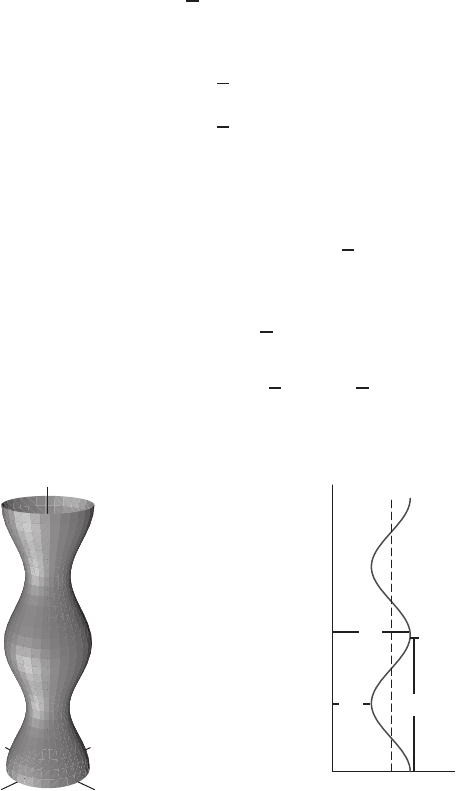
21.1 SOLUTIONS 1845
Hence
x
~
i+y~
j+z~
k= (x0
~
i+y0~
j+z0~
k) + 4 ~v1+ 2 ~v2
= (x0
~
i+y0~
j+z0~
k) + 4(2
~
i−3~
j+ 2~
k) + 2(
~
i+ 4~
j+ 5~
k)
= (x0+ 10)
~
i+ (y0−4)~
j+ (z0+ 18)~
k .
Thus the coordinates are:
x=x0+ 10, y =y0−4, z =z0+ 18.
24. (a) Nearer to the equator.
(b) Farther from the north pole.
(c) Farther from Greenwich.
25. A horizontal circle in the northern hemisphere at a latitude of 45◦north of the equator.
26. A vertical half-circle, going from the north to south poles.
27. Set up the coordinates as in Figure 21.1. The surface is the revolution surface obtained by revolving the curve shown in
Figure 21.2 about the zaxis. From the measurements given, we obtain the equation of the curve in Figure 21.2:
x= cos π
3z+ 3,0≤z≤48
(a) Rotating this around the z-axis, and taking z=tas the parameter, we get the parametric equations
x= (cos π
3t+ 3) cos θ
y= (cos π
3t+ 3) sin θ
z=t0≤θ≤2π, 0≤t≤48
(b) We know that the points in the curve consists of cross-sections of circles parallel to the xy plane and of radius
cos((π/3)z+ 3). Thus,
Area of cross-section =πcos π
3z+ 32
Integrating over z, we get
Volume =πZ48
0cos π
3z+ 32
dz
=πZ48
0cos2π
3z+ 6 cos π
3z+ 9dz
= 456πin3.
xy
z
Figure 21.1
✻
❄
6′′
✲✛
2′′
✲✛ 4′′
x
z
3
Figure 21.2

1846 Chapter Twenty-One /SOLUTIONS
28. The sphere (x−a)2+(y−b)2+ (z−c)2=d2has center at the point (a, b, c)and radius d. We use spherical coordinates
θand φas the two parameters. The parameterization of the sphere with center at the origin and radius dis
x=dsin φcos θ, y =dsin φsin θ, z =dcos φ.
Since the given sphere has center at the point (a, b, c)we add the displacement vector a
~
i+b~
j+c~
kto the radial vector
corresponding to a parameterization of the sphere with center at the origin and radius dto give
x=a+dsin φcos θ, 0≤φ≤π,
y=b+dsin φsin θ, 0≤θ≤2π,
z=c+dcos φ.
To check that this is a parameterization for the given sphere, we substitute for x,y,z:
(x−a)2+ (y−b)2+ (z−c)2
=d2sin2φcos2θ+d2sin2φsin2θ+d2cos2φ
=d2sin2φ+d2cos2φ=d2.
29. Let (θ, π/2) be the original coordinates. If θ < π, then the new coordinates will be (θ+π, π/4). If θ≥π, then the new
coordinates will be (θ−π, π/4).
30. If we set z=u,x2+y2=u2is the equation of a circle with radius |u|. Hence a parameterization of the cone is:
x=ucos v,
y=usin v, 0≤v≤2π,
z=u.
31. Since the parameterization in Example 6 on page 1079 was r= (1 −z
h)aand since the cone is given by z=r, we have
z= (1 −r
a)h. The parameterization we want is
x=rcos θ, 0≤r≤a,
y=rsin θ, 0≤θ≤2π,
z=1−r
ah.
32. The plane in which the circle lies is parameterized by
~r (p, q) = x0
~
i+y0~
j+z0~
k+p~u +q~v .
Because ~u and ~v are perpendicular unit vectors, the parameters pand qestablish a rectangular coordinate system on this
plane exactly analogous to the usual xy-coordinate system, with (p, q) = (0,0) corresponding to the point (x0, y0, z0).
Thus the circle we want to describe, which is the circle of radius acentered at (p, q) = (0,0), can be parameterized by
p=acos t, q =asin t.
Substituting into the equation of the plane gives the desired parameterization of the circle in 3-space,
~r (t) = x0
~
i+y0~
j+z0~
k+acos t~u +asin t~v ,
where 0≤t≤2π.
33. (a) Add second and third equations to get y+z= 1 + 2s. Thus, y+z= 1 + xor −x+y+z= 1, which is the
equation of a plane. Now, s=x/2, and t= (y−z+ 1)/2, so the conditions 0≤s≤1,0≤t≤1are equivalent
to 0≤x≤2,0≤y−z+ 1 ≤2or 0≤x≤2,−1≤y−z≤1.

21.1 SOLUTIONS 1847
(b) The surface is shown in Figure 21.3.
xy
z
Figure 21.3
: The surface x= 2s,
y=s+t,z= 1 + s−t, for
0≤s≤1,0≤t≤1
34. (a) z2= 1 −s2−t2= 1 −x2−y2. So x2+y2+z2= 1 which is the equation of a sphere. The conditions s2+t2≤1,
s, t ≥0are equivalent to x2+y2≤1and x, y ≥0. But if x2+y2+z2= 1, then x2+y2≤1is satisfied
automatically, so our surface is defined by:
x2+y2+z2= 1, x, y, z ≥0.
(b) The surface x=s,y=t,z=√1−s2−t2for s2+t2≤1,s, t ≥0is shown in Figure 21.4.
xy
z
Figure 21.4
35. (a) From the first two equations we get:
s=x+y
2, t =x−y
2.
Hence the equation of our surface is:
z=x+y
22
+x−y
22
=x2
2+y2
2,
which is the equation of a paraboloid.
The conditions: 0≤s≤1,0≤t≤1are equivalent to: 0≤x+y≤2,0≤x−y≤2. So our surface is
defined by:
z=x2
2+y2
2,0≤x+y≤2 0 ≤x−y≤2
(b) The surface is shown in Figure 21.5.
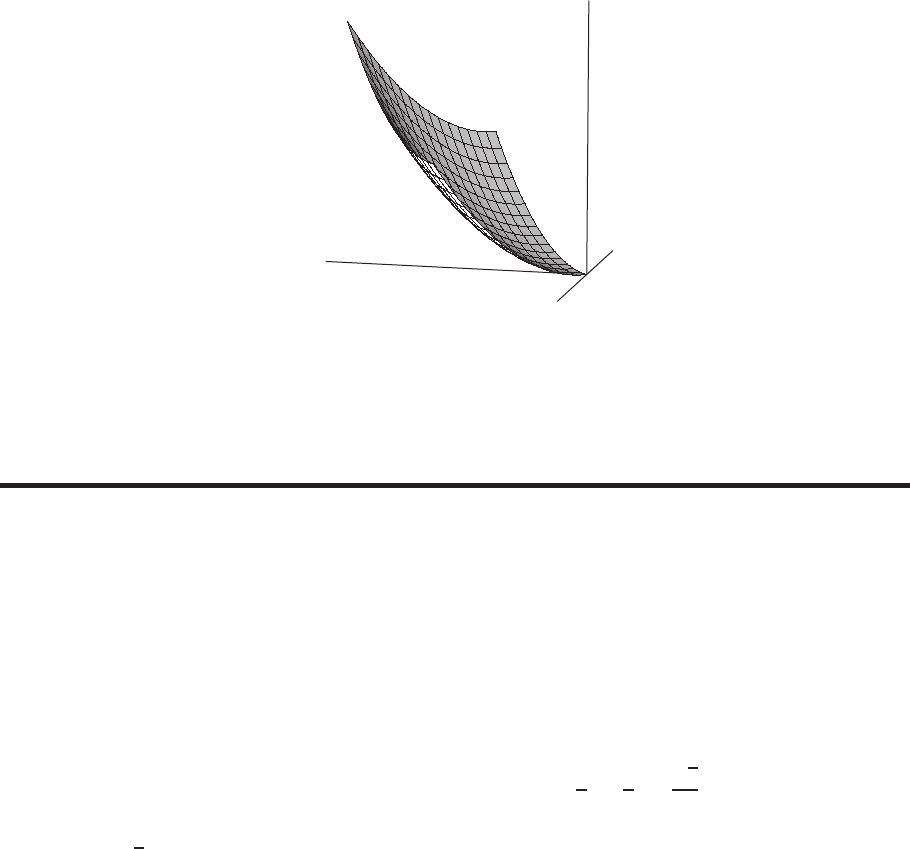
1848 Chapter Twenty-One /SOLUTIONS
x
y
z
Figure 21.5
: The surface x=s+t,
y=s−t,z=s2+t2for 0≤s≤1,
0≤t≤1
Strengthen Your Understanding
36. A counter example is provided by an unusual parameterization of the xy-plane:
~r (s, t) = s
~
i+ (s+t)~
j .
The parameter curves with tconstant are lines parallel to ~v 1=~
i+~
j, and the parameter curves with sconstant are lines
parallel to ~v 2=~
j. Since ~v 1and ~v 2are not orthogonal, neither are the parameter curves.
37. A parameter curve for constant φon the sphere is parameterized by
~r1(θ) = Rsin φcos θ
~
i+Rsin φsin θ~
j+Rcos φ~
k .
It is a circle with radius Rsin φ.
38. The point on the unit sphere where θ=π/4and φ=π/4has position vector
~r 0= sin φcos θ
~
i+ sin φsin θ~
j+ cos φ~
k=1
2~
i+1
2~
j+√2
2~
k .
Vectors perpendicular to the radius vector ~r 0are parallel to the tangent plane. Two such vectors are ~v 1=~
i−~
j
and ~v 2=√2~
i−~
k. A parameterization of the tangent plane can be given by
~r (s, t) = ~r 0+s~v 1+t~v 2.
39. Since
x=s+ 1, y =t+ 2, z =s+t
we have x+y=z+ 3. Therefore, an equation for the plane is given by
f(x, y, z) = x+y−z−3 = 0.
40. To give a parameterized curve on the sphere, we assign a point on the sphere to every parameter value t, by giving values
of θand φ. For example, letting θ=tand φ=t2we have the curve
~r 1(t) = sin t2cos t~
i+ sin t2sin t~
j+ cos t2~
k
which is not a parameter curve because neither θnor φis constant.
41. True. The plane passes through the point (1,−2,3) and contains the vectors~
iand ~
j .
42. False. There is only one parameter, s. The equations parameterize a line.
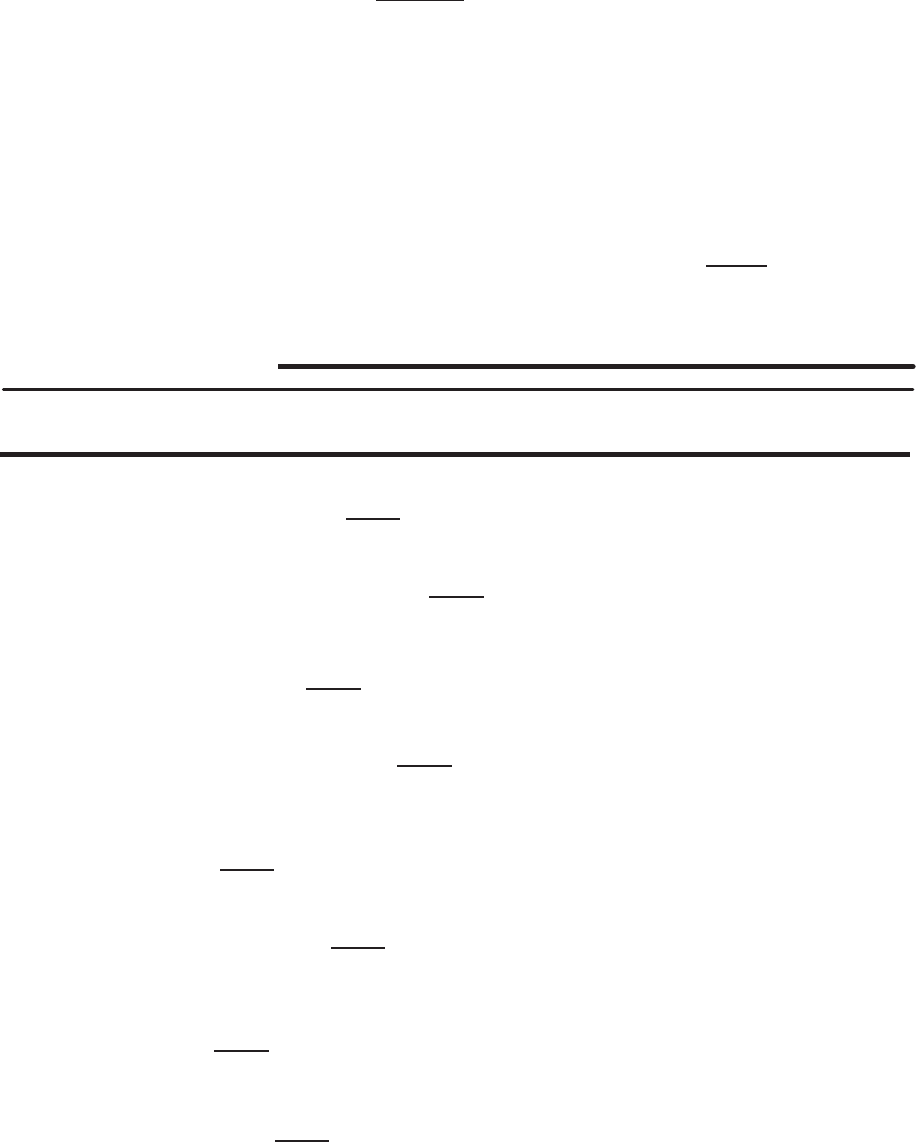
21.2 SOLUTIONS 1849
43. True. The position vector of a point on the lower hemisphere is the negative of the position vector of the opposite point
on the upper hemisphere. As ~r ranges over all points in the upper hemisphere, −~r ranges over all points in the lower
hemisphere.
44. False. For example, if ~r (s, t) = s
~
i+t~
j+√1−s2−t2~
kwith (s, t)inside the unit disk s2+t2≤1then ~r (−s, −t)
parameterizes the same upper hemisphere.
45. True. Adding a constant vector shifts the plane by a corresponding displacement, keeping it parallel to the original plane.
46. True. If the surface is parameterized by ~r (s, t)and the point has parameters (s0, t0)then the parameter curves ~r (s0, t)
and ~r (s, t0)pass through (s0, t0).
47. False. For example, the lines of longitude on a sphere correspond to different values of the parameter θ, but all pass
through the north and south poles.
48. (I) Part of a plane, since z=x+y.
(II) Part of a cylinder of radius 1 with center on the z-axis, since x2+y2= 1.
(III) Part of a sphere of radius 1 centered at the origin, since x2+y2+z2= 1. With s=φand t=θthis is the
usual parameterization of the sphere using spherical coordinates.
(IV) Part of a cone with vertex at the origin and central axis on the z-axis, since z=px2+y2.
The match-up is: I-b, II-a, III-c, IV-d
Solutions for Section 21.2
Exercises
1. We have
∂(x, y)
∂(s, t)=
xsxt
ysyt
=
5 2
3 1
=−1.
Therefore,
∂(x, y)
∂(s, t)= 1.
2. We have
∂(x, y)
∂(s, t)=
xsxt
ysyt
=
2s−2t
2t2s
= 4s2+ 4t2.
Therefore,
∂(x, y)
∂(s, t)= 4s2+ 4t2.
Notice we can drop the absolute value signs because in this case the Jacobian is nonnegative for all sand t.
3. We have
∂(x, y)
∂(s, t)=
xsxt
ysyt
=
escos t−essin t
essin t escos t
= (escos t)2+ (essin t)2.
Therefore,
∂(x, y)
∂(s, t)=e2s(cos2t+ sin2t)=e2s.
Notice we can drop the absolute value signs because the Jacobian in this case is positive for all sand t.
4. We have
∂(x, y)
∂(s, t)=
xsxt
ysyt
=
3s2−3t2−6st
6st 3s2−3t2
= 9(s2−t2)2+ 36s2t2.
Therefore, multiplying out and simplifying
∂(x, y)
∂(s, t)= 9 s4−2s2t2+t4+ 4s2t2= 9(s2+t2)2.
Notice we can drop the absolute value sign since the Jacobian in this case is nonnegative for all sand t.
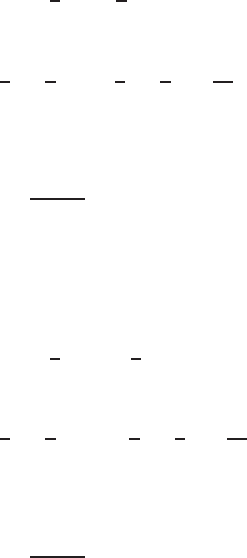
1850 Chapter Twenty-One /SOLUTIONS
5. The square Tis defined by the inequalities
0≤s=ax ≤1 0 ≤t=by ≤1
that correspond to the inequalities
0≤x≤1/a = 10 0 ≤y≤1/b = 1
that define R. Thus a= 1/10 and b= 1.
6. The square Tis defined by the inequalities
0≤s=ax ≤1 0 ≤t=by ≤1
that correspond to the inequalities
0≤x≤1/a = 1 0 ≤y≤1/b = 1/4
that define R. Thus a= 1 and b= 4.
7. The square Tis defined by the inequalities
0≤s=ax ≤1 0 ≤t=by ≤1
that correspond to the inequalities
0≤x≤1/a = 50 0 ≤y≤1/b = 10
that define R. Thus a= 1/50 and b= 1/10.
8. Inverting the change of coordinates gives x=s−at,y=t.
The four edges of Rare
y= 0, y = 3, y =1
4x, y =1
4(x−10).
The change of coordinates transforms the edges to
t= 0, t = 3, t =1
4s−1
4at, t =1
4s−1
4at −10
4.
These are equations for the edges of a rectangle in the st-plane if the last two are of the form: s= (Constant). This
happens when the tterms drop out, or a=−4. With a=−4the change of coordinates gives
Z ZT
∂(x, y)
∂(s, t)ds dt
over the rectangle
T: 0 ≤t≤3,0≤s≤10.
9. Inverting the change of coordinates gives x=s−at,y=t.
The four edges of Rare
y= 0, y = 5, y =−1
3x, y =−1
3(x−10).
The change of coordinates transforms the edges to
t= 0, t = 5, t =−1
3s+1
3at, t =−1
3s+1
3at +10
3.
These are equations for the edges of a rectangle in the st-plane if the last two are of the form: s= (Constant). This
happens when the tterms drop out, or a= 3. With a= 3 the change of coordinates gives
Z ZT
∂(x, y)
∂(s, t)ds dt
over the rectangle
T: 0 ≤t≤5,0≤s≤10.
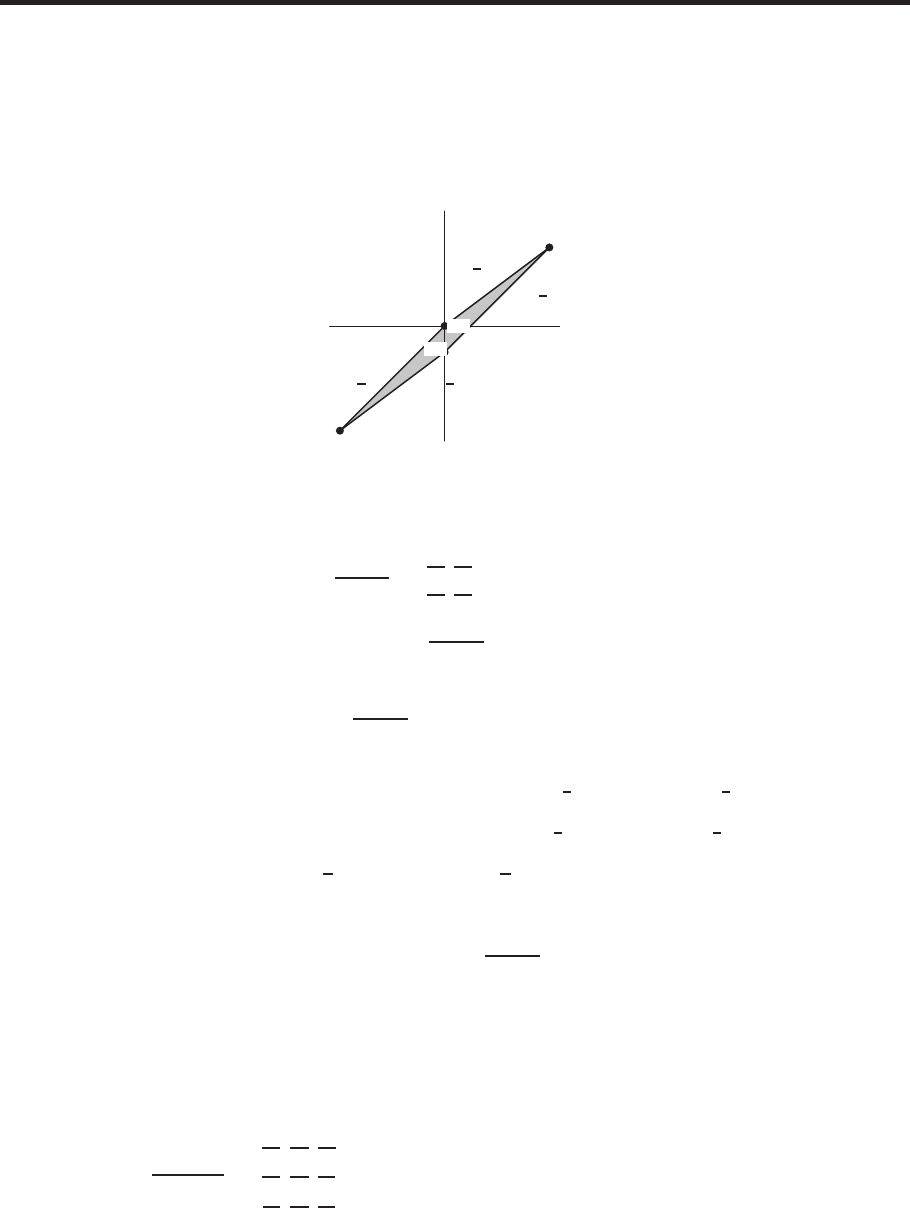
21.2 SOLUTIONS 1851
Problems
10. Given T={(s, t)|0≤s≤3,0≤t≤2}and
(x=2s−3t
y=s−2t
The shaded area in Figure 21.6 is the corresponding region Rin the xy-plane.
x
y
(0,0)
(0,−1)
(−6,−4)
(6,3)
R1
R2
y=1
2x−1
y=2
3x−1
y=2
3x
y=1
2x
Figure 21.6
Since
∂(x, y)
∂(s, t)=
∂x
∂s
∂x
∂t
∂y
∂s
∂y
∂t
=
2−3
1−2
=−1,
∂(x, y)
∂(s, t)= 1.
Thus we get ZT
∂(x, y)
∂(s, t)ds dt =Z3
0
dsZ2
0
dt = 6.
Since
ZR
dx dy =ZR1
dx dy +ZR2
dx dy =Z0
−6
dx Z2
3x
1
2x−1
dy +Z6
0
dx Z1
2x
2
3x−1
dy
=Z0
−61
6x+ 1dx +Z6
0−1
6x+ 1dx = 3 + 3 = 6,
thus ZR
dx dy =ZT
∂(x, y)
∂(s, t)ds dt.
11. Given
x=ρsin φcos θ
y=ρsin φsin θ
z=ρcos φ,
∂(x, y, z)
∂(ρ, φ, θ)=
∂x
∂ρ
∂x
∂φ
∂x
∂θ
∂y
∂ρ
∂y
∂φ
∂y
∂θ
∂z
∂ρ
∂z
∂φ
∂z
∂θ
=
sin φcos θ ρ cos φcos θ−ρsin φsin θ
sin φsin θ ρ cos φsin θ ρ sin φcos θ
cos φ−ρsin φ0
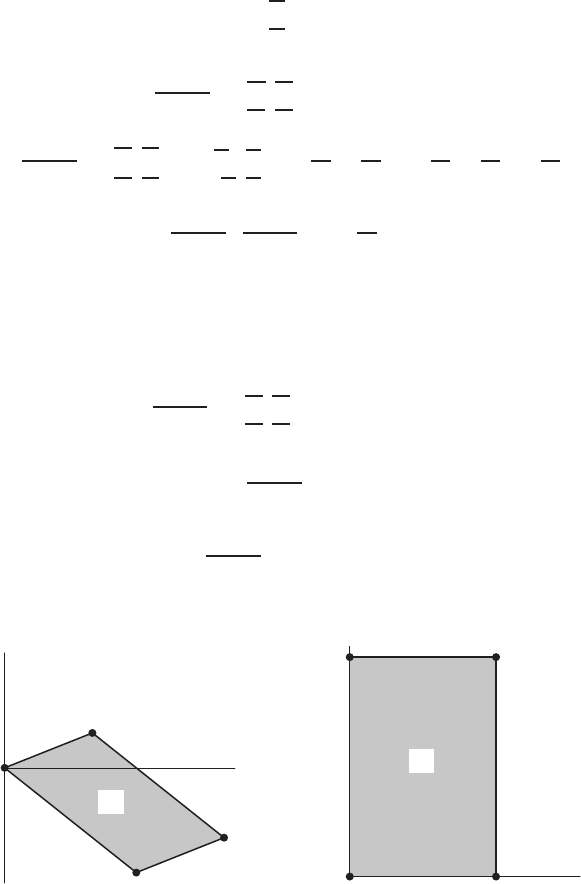
1852 Chapter Twenty-One /SOLUTIONS
= cos φ
ρcos φcos θ−ρsin φsin θ
ρcos φsin θ ρ sin φcos θ
+ρsin φ
sin φcos θ−ρsin φsin θ
sin φsin θ ρ sin φcos θ
= cos φ(ρ2cos2θcos φsin φ+ρ2sin2θcos φsin φ)
+ρsin φ(ρsin2φcos2θ+ρsin2φsin2θ)
=ρ2cos2φsin φ+ρ2sin3φ
=ρ2sin φ.
12. Given (x=3s−4t
y= 5s+ 2t,
we have (s=1
13 (x+ 2y)
t=1
26 (3y−5x).
Since
∂(x, y)
∂(s, t)=
∂x
∂s
∂x
∂t
∂y
∂s
∂y
∂t
=
3−4
5 2
= 26,
∂(s, t)
∂(x, y)=
∂s
∂x
∂s
∂y
∂t
∂x
∂t
∂y
=
1
13
2
13
−5
26
3
26
=3
26 1
13 +5
26 2
13 =1
26 .
So ∂(x, y)
∂(s, t)·∂(s, t)
∂(x, y)= 26 ·1
26 = 1.
13. Given (x=2s+t
y=s−t,
we have
∂(x, y)
∂(s, t)=
∂x
∂s
∂x
∂t
∂y
∂s
∂y
∂t
=
2 1
1−1
=−3,
hence
∂(x, y)
∂(s, t)= 3.
We get ZR
(x+y)dA=ZT
3s
∂(x, y)
∂(s, t)dsdt =ZT
(3s)(3) ds dt = 9 ZT
s ds dt,
where Tis the region in the st-plane corresponding to R.
x
y
(0,0)
(3,−3)
(5,−2)
(2,1)
R
Figure 21.7
s
t
(0,0)
(0,3)
(1,0)
(1,3)
T
Figure 21.8
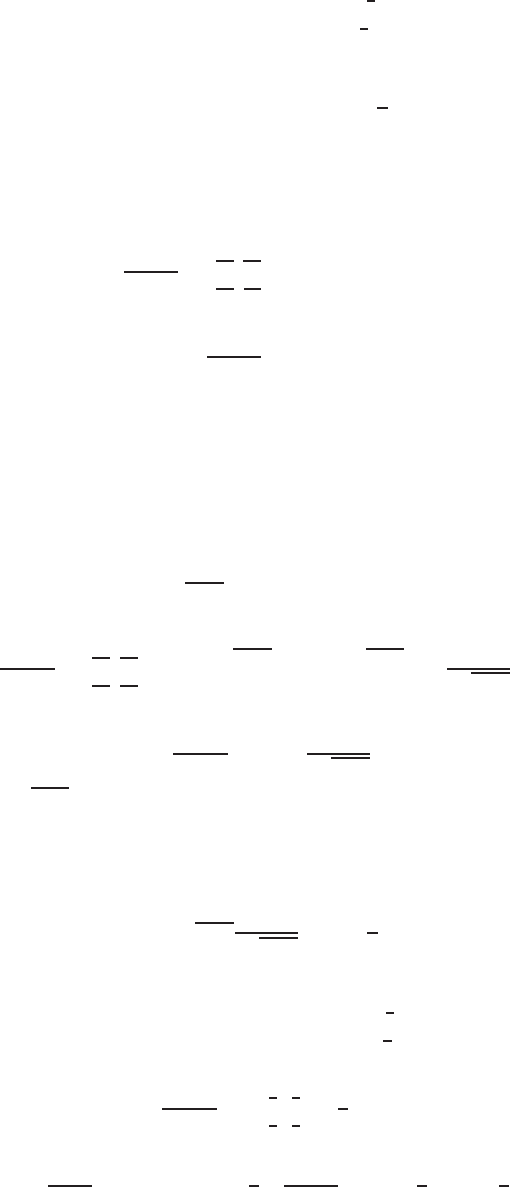
21.2 SOLUTIONS 1853
Now, we need to find T.
As (x= 2s+t
y=s−tor (s=1
3(x+y)
t=1
3(x−2y),
so from the above transformation and Figure 21.7, Tis the shaded area in Figure 21.8. Therefore
ZR
(x+y)dA = 9 Z1
0
s ds Z3
0
dt = (27)( 1
2) = 13.5.
14. The area of the ellipse is RRRdx dy where Ris the region x2+ 2xy + 2y2≤1. We must change coordinates in both
the area element dA =dx dy and the region R.
Inverting the coordinate change gives x=s−t,y=t. Thus
∂(x, y)
∂(s, t)=
∂x
∂s
∂x
∂t
∂y
∂s
∂y
∂t
=
1−1
01
= 1.
Therefore
dx dy =
∂(x, y)
∂(s, t)ds dt =ds dt.
The region of integration is
x2+ 2xy + 2y2= (s−t)2+ 2(s−t)t+ 2t2=s2+t2≤1.
Let Tbe the unit disc s2+t2≤1. We have
Z ZR
dx dy =Z ZT
ds dt =Area of T=π.
15. We must change coordinates in the area element dA =dx dy, the integrand xand the region R.
Inverting the coordinate change gives x=√s−t,y=swhere we use the positive square root because the region
Ris in the first quadrant where x≥0. Thus
∂(x, y)
∂(s, t)=
∂x
∂s
∂x
∂t
∂y
∂s
∂y
∂t
=
1/(2√s−t)−1/(2√s−t)
1 0
=1
2√s−t.
Therefore
dx dy =
∂(x, y)
∂(s, t)ds dt =1
2√s−tds dt.
The integrand is x=√s−t.
The region of integration can be transformed by examination of its boundaries. The left and right boundaries of R
are given by y−x2=t= 0 and y−x2=t=−9. The bottom and top boundaries of Rare given by y=s= 0 and
y=s= 16.
Let Tbe the rectangle 0≤s≤16,−9≤t≤0of area (9)(16) = 144. We have
Z ZR
xdx dy =Z ZT
√s−t1
2√s−tds dt =1
2(Area of T) = 72.
16. Let (s=x−y
t=x+y,that is (x=1
2(s+t)
y=1
2(t−s),
we get
∂(x, y)
∂(s, t)=
1
2
1
2
−1
2
1
2
=1
2.
Hence
I=ZR
cos x−y
x+ydx dy =ZT
cos s
t
∂(x, y)
∂(s, t)ds dt =1
2ZT
cos s
tds dt,
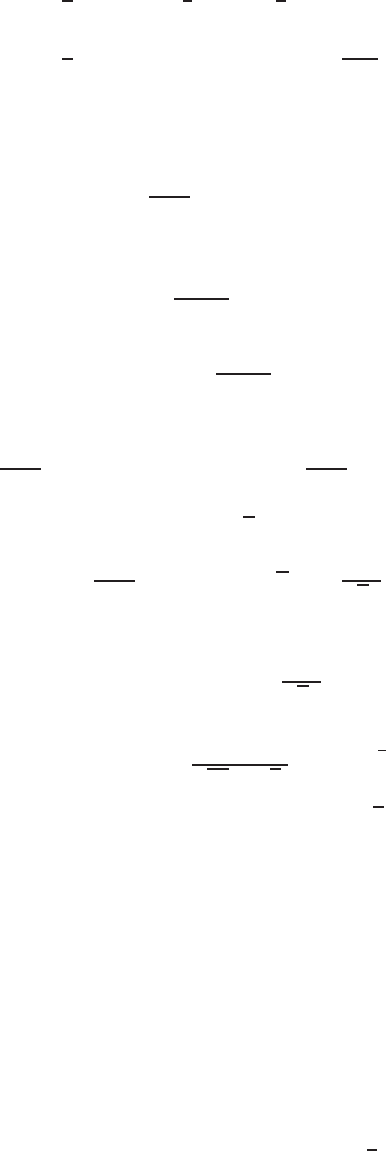
1854 Chapter Twenty-One /SOLUTIONS
where Ris the triangle bounded by x+y= 1,x= 0,y= 0 and Tis its image which is the triangle bounded by t= 1,
s=−t,s=t.
Then
I=1
2Z1
0Zt
−t
cos s
tds dt =1
2Z1
0
t[sin(1) −sin(−1)] dt
=1
2Z1
0
t·2 sin 1 dt = sin 1 Z1
0
t dt =sin 1
2= 0.42.
17. (a) The probability that (x+y)/2is less than or equal to tis the integral of the joint density function p(x, y)over the
infinite region (half plane) where (x+y)/2≤t. Thus
F(t) = 1
2πσ2Z∞
−∞ Z2t−x
−∞
e−(x2+y2)/(2σ2)dy dx.
(b) With u= (x+y)/2,v= (x−y)/2, we have x=u+v,y=u−v. Thus
∂(x, y)
∂(u, v)=
1 1
1−1=−2
so
dx dy =
∂(x, y)
∂(u, v)du dv = 2du dv.
Also x2+y2= 2(u2+v2). After writing the limits of integration in the uv-coordinates, we have
F(t) = 1
2πσ2Zt
−∞ Z∞
−∞
e−(u2+v2)/σ22dv du =2
2πσ2Zt
−∞
e−u2/σ2Z∞
−∞
e−v2/σ2dv du.
Continuing using the fact that R∞
−∞e−x2/a2dx =a√πwith areplaced by σ, we obtain
F(t) = 2
2πσ2Zt
−∞
e−u2/σ2(σ√π)du =1
√πσ Zt
−∞
e−u2/σ2du.
(c) The probability density function of zis the derivative of its cumulative distribution function F(t). By the Fundamental
Theorem of Calculus,
p(t) = F′(t) = 1
√πσ e−t2/σ2.
(d) Since the density function for zcan be written in the form
p(t) = 1
√2π(σ/√2) e−t2/(2(σ/√2)2),
the distribution of zis normal, with mean 0 and standard deviation σ/√2.
Notice that the standard deviation of the average z= (x+y)/2is less than the standard deviations of the
individual numbers xand y. The average of two random numbers is more likely to be near the mean than are either
of the two numbers individually.
18. Let’s denote the (x, y)coordinates of the points in the lagoon by L. Since xand yare measured in kilometers and dis
measured in meters, and 1km = 1000 m, the volume of a small piece of the lagoon is given by
∆V≈d(x, y)(1000∆x)(1000∆y)m3.
Thus, the total volume of the lagoon is given by
V= 10002ZL
d(x, y)dxdy.
Changing coordinates using u=x/2and v=y−f(x)converts the depth function to:
d(x(u, v), y(u, v)) = 40 −160v2−160u2= 160( 1
4−u2−v2)meters.

21.2 SOLUTIONS 1855
Thus, the points in the lagoon have (u, v)coordinates in the disk, D, given by u2+v2≤1/4.
The Jacobian of the transformation is:
∂x
∂u
∂x
∂v
∂y
∂u
∂y
∂v
=
2 0
2f′(2u) 1
= 2.
Thus, the integral in u, v coordinates is
V= 10002ZL
d(x, y)dxdy = 106ZD
160( 1
4−u2−v2)2 dudv = 320 ·106ZD
(1
4−u2−v2)dudv.
Converting to polar coordinates, we have
V= 320 ·106Z2π
0Z1/2
0
(1
4−r2)r drdθ = 320 ·1062π(1
4
r2
2−r4
4)
1/2
0
= 107πm3.
Strengthen Your Understanding
19. The region Rdoes not correspond to the region T. The region Rcorresponds separately to both
T1: 0 ≤s≤1,−2≤t≤0and to T2: 0 ≤s≤1,0≤t≤2.
In a change of coordinates for the integral over R, we use only one of these two regions. Both the following integrals are
correct: ZR
f(x, y)dx dy =ZT1
f(s, t2)
∂(x, y)
∂(s, t)ds dt
and ZR
f(x, y)dx dy =ZT2
f(s, t2)
∂(x, y)
∂(s, t)ds dt.
20. The Jacobian for the change of coordinates is given by
∂(x, y)
∂(s, t)=
0 3t2
10
=−3t2.
The change of coordinates formula requires the absolute value of the Jacobian. The correct formula is
ZR
(x+2y)dx dy =ZTt3+ 2s3t2ds dt
21. The change of coordinates x= 2s,y= 3ttransforms the region 0≤s≤1,0≤t≤1in the st-plane into the rectangle
0≤x≤2,0≤y≤3in the xy-plane.
22. Let x= 2s,y=t. Geometrically, this change of coordinates stretches every region in the horizontal direction by a factor
of 2, while leaving the vertical distances the same, which doubles the area.
To see this analytically, let Tbe a region in the st-plane, corresponding to region Rin the xy-plane. We have
∂(x, y)
∂(s, t)=
∂x
∂s
∂x
∂t
∂y
∂s
∂y
∂t
=
2 0
0 1
= 2.
Hence
Area of R=ZR
dx dy =ZT
∂(x, y)
∂(s, t)ds dt =ZT
2ds dt = 2 ·Area of T .
23. False. The change of variable leaves the value of the integral unchanged. Thus, calculating the value of the s, t-integral
gives you the value of the x, y-integral.
24. False. The Jacobian can be negative; we use the absolute value of the Jacobian in the integral.
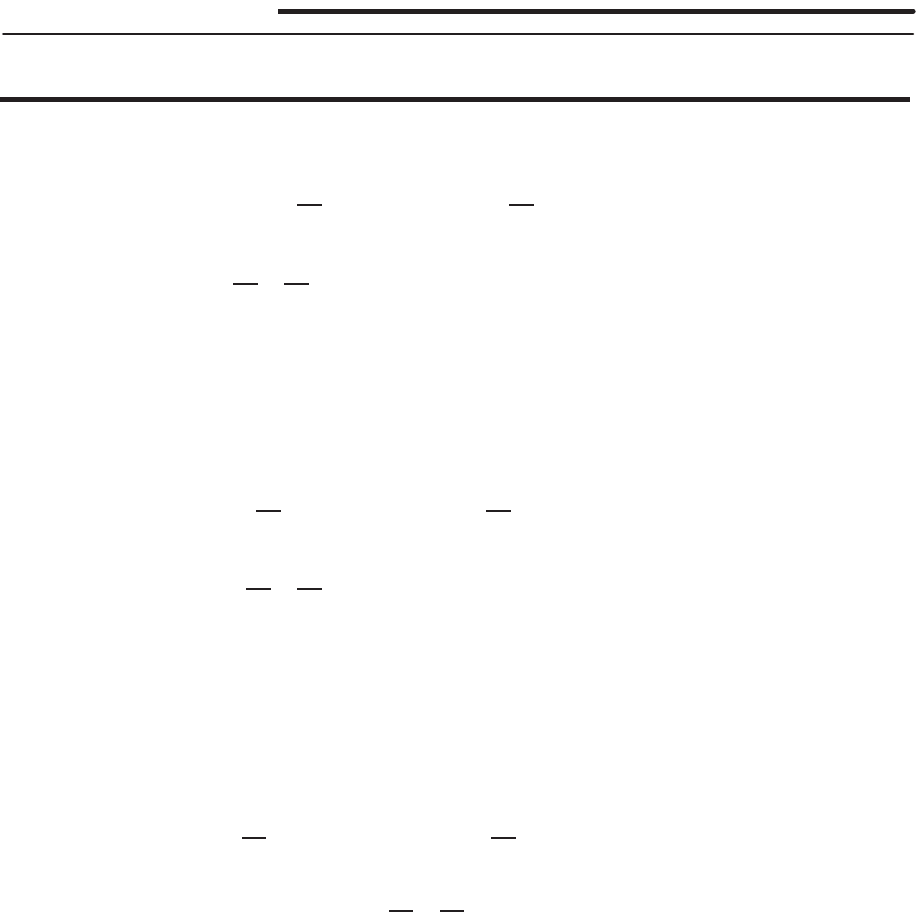
1856 Chapter Twenty-One /SOLUTIONS
Solutions for Section 21.3
Exercises
1. Since
~r (s, t) = (s+t)
~
i+ (s−t)~
j+st ~
k ,
we have ∂~r
∂s =~
i+~
j+t~
kand ∂~r
∂t =~
i−~
j+s~
k ,
so
d~
A=∂~r
∂s ×∂~r
∂t ds dt =
~
i~
j~
k
1 1 t
1−1s
ds dt = ((s+t)
~
i−(s−t)~
j−2~
k)ds dt.
For the opposite orientation, d~
Ahas the opposite sign:
d~
A=−((s+t)
~
i−(s−t)~
j−2~
k)ds dt.
2. Since
~r (s, t) = sin t~
i+ cos t~
j+ (s+t)~
k ,
we have ∂~r
∂s = 0~
i+ 0~
j+~
kand ∂~r
∂t = cos t~
i−sin t~
j+~
k ,
so
d~
A=∂~r
∂s ×∂~r
∂t ds dt =
~
i~
j~
k
0 0 1
cos t−sin t1
ds dt = (sin t~
i+ cos t~
j)ds dt.
For the opposite orientation, d~
Ahas the opposite sign:
d~
A=−(sin t~
i+ cos t~
j)ds dt.
3. Since
~r (s, t) = es~
i+ cos t~
j+ sin t~
k ,
we have ∂~r
∂s =es~
i+ 0~
j+ 0~
kand ∂~r
∂t = 0
~
i−sin t~
j+ cos t~
k ,
so
d~
A=∂~r
∂s ×∂~r
∂t ds dt
=
~
i~
j~
k
es0 0
0−sin tcos t
ds dt
= (−escos t~
j−essin t~
k)ds dt
=−es(cos t~
j+ sin t~
k)ds dt.
For the opposite orientation, d~
Ahas the opposite sign:
d~
A=es(cos t~
j+ sin t~
k)ds dt.
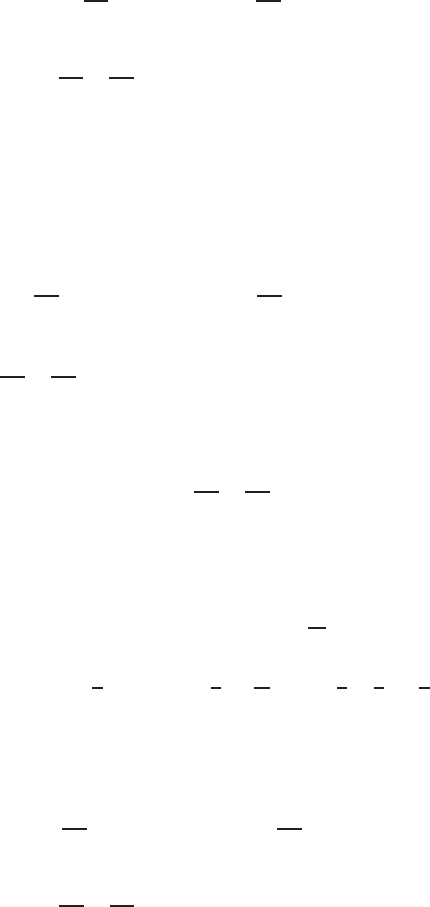
21.3 SOLUTIONS 1857
4. Since
~r (u, v) = (u+v)~
j+ (u−v)~
k ,
we have ∂~r
∂u =~
j+~
kand ∂~r
∂v =~
j−~
k ,
so
d~
A=∂~r
∂u ×∂~r
∂v du dv =
~
i~
j~
k
0 1 1
0 1 −1
du dv =−2~
i du dv.
For the opposite orientation, d~
Ahas the opposite sign:
d~
A= 2~
i du dv.
5. Since Sis given by
~r (s, t) = (s+t)
~
i+ (s−t)~
j+ (s2+t2)~
k ,
we have ∂~r
∂s =~
i+~
j+ 2s~
kand ∂~r
∂t =~
i−~
j+ 2t~
k ,
and
∂~r
∂s ×∂~r
∂t =
~
i~
j~
k
11 2s
1−1 2t
= (2s+ 2t)
~
i+ (2s−2t)~
j−2~
k .
Since the ~
kcomponent of this vector is negative, it points down, and so has the opposite orientation to the one specified.
Thus, we use
d~
A=−∂~r
∂s ×∂~r
∂t ds dt,
and so we have
ZS
~
F·d~
A=−Z1
0Z1
0
(s2+t2)~
k·(2s+2t)
~
i+ (2s−2t)~
j−2~
kds dt
= 2 Z1
0Z1
0
(s2+t2)ds dt = 2 Z1
0s3
3+st2
s=1
s=0
dt
= 2 Z1
0
(1
3+t2)dt = 2( 1
3t+t3
3)
1
0
= 2( 1
3+1
3) = 4
3.
6. Since Sis parameterized by
~r (s, t) = 2s
~
i+ (s+t)~
j+ (1 + s−t)~
k ,
we have ∂~r
∂s = 2
~
i+~
j+~
kand ∂~r
∂t =~
j−~
k ,
so
∂~r
∂s ×∂~r
∂t =
~
i~
j~
k
2 1 1
0 1 −1
=−2
~
i+ 2~
j+ 2~
k ,
which points upward, in the direction opposite to the orientation given. Thus,
ZS
~
F·d~
A=−Z1
0Z1
0
(2s
~
i+ (s+t)~
j)(−2
~
i+ 2~
j+ 2~
k)ds dt
=−Z1
0Z1
0
(−4s+ 2s+ 2t)dsdt =Z1
0Z1
0
(2s−2t)ds dt
=Z1
0 s2−2st
s=1
s=0!dt =Z1
0
(1 −2t)dt =t−t2
1
0
= 0.

1858 Chapter Twenty-One /SOLUTIONS
7. The cross-product ∂~r /∂s ×∂~r /∂t is given by
∂~r
∂s ×∂~r
∂t =
~
i~
j~
k
es06
0−3 sin(3t) 0
= 18 sin(3t)
~
i−3essin(3t)~
k .
Since the z-component, −3essin(3t), of ∂~r /∂s ×∂~r /∂t is always negative for 0≤s≤4and 0<t<π/6, the vector
∂~r /∂s ×∂~r /∂t points downward and so in the direction of the given orientation of S.
Thus,
d~
A=∂~r
∂s ×∂~r
∂t ds dt
and
ZS
~
F·d~
A=Z4
0Zπ/6
0
(es
~
i)·(18 sin(3t)
~
i−3essin(3t)~
j)dt ds
=Z4
0Zπ/6
0
18essin(3t)dt ds =−18 Z4
0
escos(3t)
3
π/6
0
ds
=−6Z4
0
es(0 −1) ds = 6 Z4
0
esds = 6(e4−1).
8. Since Sis parameterized by
~r (s, t) = 3 sin s
~
i+ 3 cos s~
j+ (t+ 1)~
k ,
we have ∂~r
∂s = 3 cos s
~
i−3 sin s~
jand ∂~r
∂t =~
k .
So
∂~r
∂s ×∂~r
∂t =
~
i~
j~
k
3 cos s−3 sin s0
0 0 1
=−3 sin s
~
i−3 cos s~
j ,
which points toward the z-axis and thus opposite to the orientation we were given. Hence, we use
d~
A=−∂~r
∂s ×∂~r
∂t ds dt,
and so we have
ZS
~
F·d~
A=−Z1
0Zπ
0
(3 cos s
~
i+ 3 sin s~
j)·(−3 sin s
~
i−3 cos s~
j)ds dt
= 9 Z1
0Zπ
0
2sin scos s ds dt = 9 Z1
0Zπ
0
sin 2s ds dt
= 9 Z1
0−cos 2s
2
s=π
s=0 dt = 0.
9. Using cylindrical coordinates, we see that the surface Sis parameterized by
~r (r, θ) = rcos θ
~
i+rsin θ~
j+r~
k .
We have
∂~r
∂r ×∂~r
∂θ =
~
i~
j~
k
cos θsin θ1
−rsin θ r cos θ0
=−rcos θ
~
i−rsin θ~
j+r~
k .
Since the vector ∂~r /∂r ×∂~r /∂θ points upward, in the direction opposite to the specified orientation, we use d~
A=
−(∂~r /∂r ×∂~r /∂θ)dr dθ. Hence
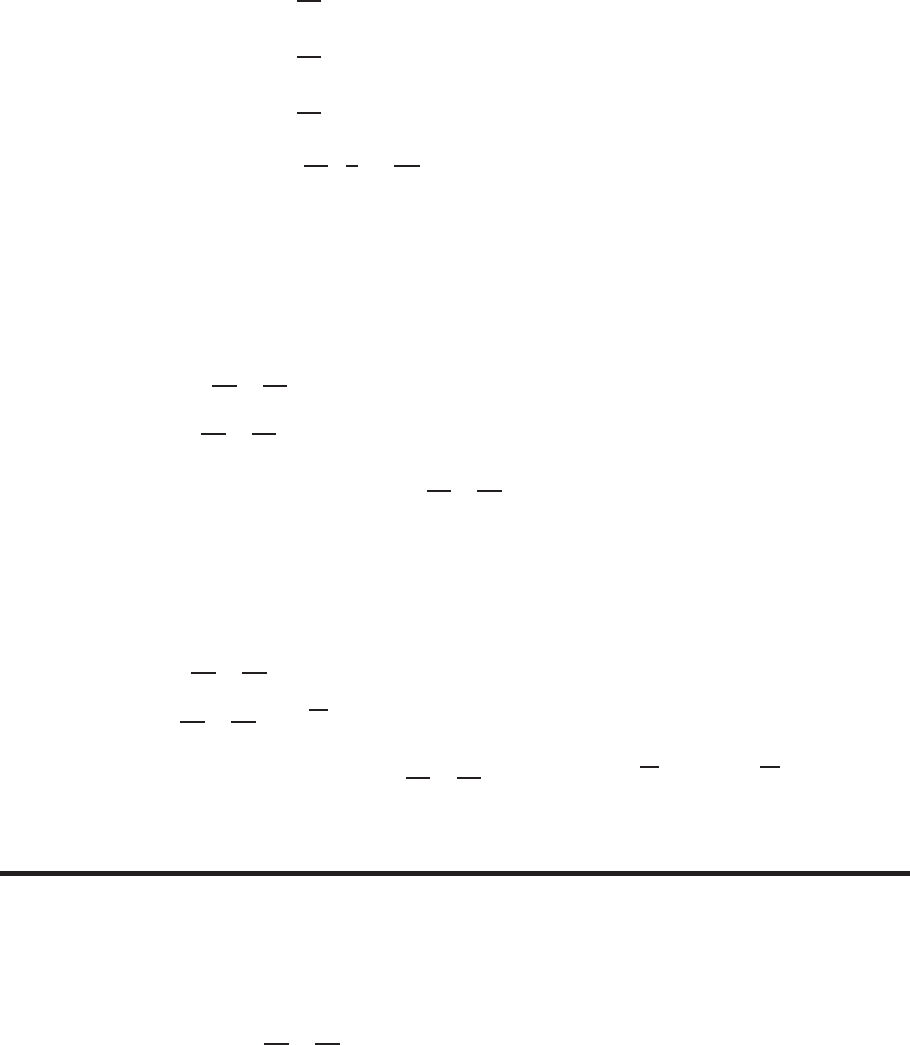
21.3 SOLUTIONS 1859
ZS
~
F·d~
A=−Z2π
0ZR
0
(r5cos2θsin2θ~
k)·(−rcos θ
~
i−rsin θ~
j+r~
k)dr dθ
=−Z2π
0ZR
0
r6cos2θsin2θ dr dθ
=−R7
7Z2π
0
sin2θcos2θ dθ
=−R7
7Z2π
0
sin2θ(1 −sin2θ)dθ
=−R7
7Z2π
0
(sin2θ−sin4θ)dθ
=−(R7
7)( π
4) = −π
28 R7.
The cone is not differentiable at the point (0,0). However the flux integral, which is improper, converges.
10. Place the cylinder Sof radius aand length Lso that its central axis is the zaxis between z= 0 and z=L. A
parameterization of Sis
x=acos θ, y =asin θ, z =t, for 0≤θ≤2π, 0≤t≤L.
We compute
∂~r
∂θ ×∂~r
∂t = (−asin θ
~
i+acos θ~
j)×~
k=acos θ
~
i+asin θ~
j
∂~r
∂θ ×∂~r
∂t
=a
Surface area =ZS
dA=ZR
∂~r
∂θ ×∂~r
∂t
dA =Z2π
θ=0 ZL
t=0
adtdθ = 2πaL.
11. A parameterization of Sis
x=s, y =t, z = 3s+ 2t, for 0≤s≤10,0≤t≤20.
We compute
∂~r
∂s ×∂~r
∂t = (
~
i+ 3~
k)×(~
j+ 2~
k) = −3
~
i−2~
j+~
k
∂~r
∂θ ×∂~r
∂t
=√14
Surface area =ZS
dA =ZR
∂~r
∂θ ×∂~r
∂t
dA =Z20
t=0 Z10
s=0
√14dsdt = 200√14.
Problems
12. The surface Sis parameterized by
~r (x, z) = x
~
i+ (x2+z2)~
j+z~
k .
The surface S, together with its given orientation ~n , is graphed in Figure 21.9. Using the right-hand rule we see that the
vector ~r x×~r zpoints in the direction of ~n . Thus,
d~
A=∂~r
∂x ×∂~r
∂z dx dz =
~
i~
j~
k
1 2x0
0 2z1
dx dz = (2x
~
i−~
j+ 2z~
k)dx dz.
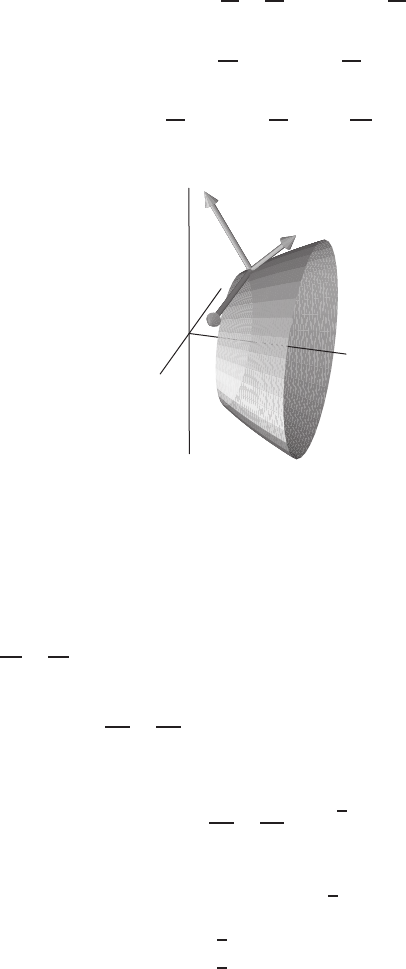
1860 Chapter Twenty-One /SOLUTIONS
Thus
ZS
~
F·d~
A=ZS
((x+z)
~
i+~
j+z~
k)·(2x
~
i−~
j+ 2z~
k)dx dz
=ZS
(2x2+ 2xz −1 + 2z2)dx dz.
Changing to polar coordinates, x=rcos θ, z =rsin θ, where 1/2≤r≤1,0≤θ≤2π, we obtain
ZS
~
F·d~
A=Z2π
0Z1
1/2
(2r2+ 2r2sin θcos θ−1)r dr dθ
=Z2π
0r4
2+r4
2sin θcos θ−r2
2
r=1
r=1/2
dθ
=Z2π
015
32 sin θcos θ+3
32 dθ
=15
64 (sin θ)2+3
32 θ
2π
0
=3π
16 .
x
y
z
~n
~rx
~rz
S
Figure 21.9
13. The plane is parameterized by
~r =x
~
i+y~
j+z~
k=x
~
i+y~
j+ (2 −2x−y)~
k ,
where (x, y)is in the disk Rlying inside the circle x2+y2= 2x. By completing the square, this circle can be rewritten
as (x−1)2+y2= 1 and so the disk has area π.
We have dA =k∂~r
∂x ×∂~r
∂y kdxdy, where
∂~r
∂x ×∂~r
∂y =
~
i~
j~
k
10−2
0 1 −1
= 2
~
i+~
j+~
k
and so
∂~r
∂x ×∂~r
∂y
=√6.
Thus, the surface area of the ellipse Sis given by
Surface area =ZS
1dA=ZR
√6dxdy
=√6×(Area of disk x2+y2= 2x)
=√6π.
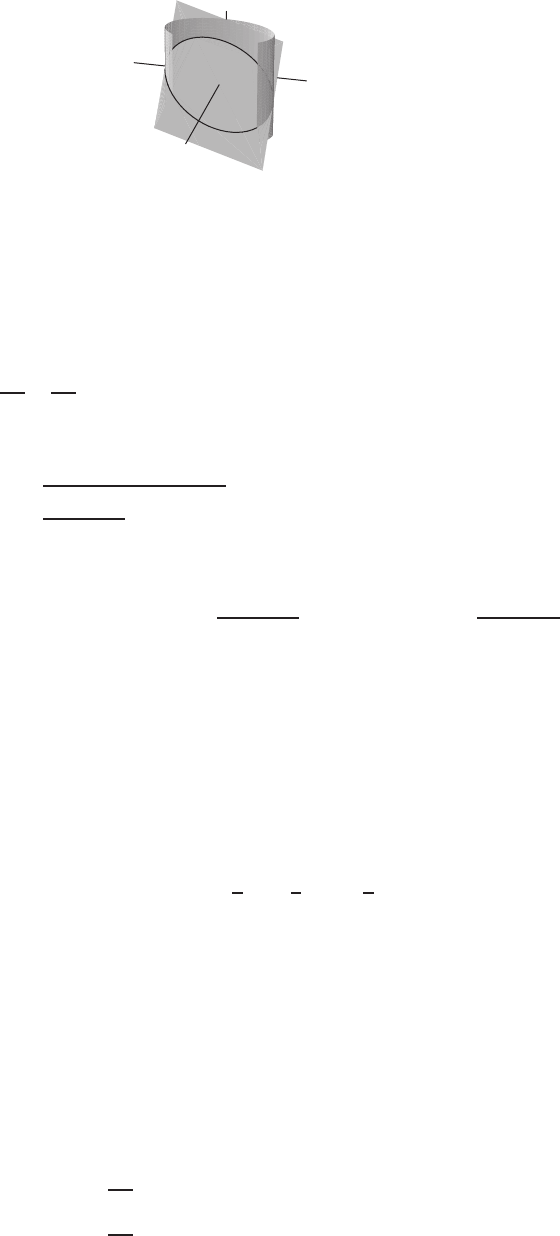
21.3 SOLUTIONS 1861
x
y
z
S
Figure 21.10
14. The surface Sis parameterized by
~r =x
~
i+f(x) cos θ~
j+f(x) sin θ~
k , a ≤x≤b, 0≤θ≤2π.
The area element on Ais
dA =
∂~r
∂x ×∂~r
∂θ
dx dθ
=k(
~
i+f′(x) cos θ~
j+f′(x) sin θ~
k)×(−f(x) sin θ~
j+f(x) cos θ~
k)kdx dθ
=kf(x)f′(x)
~
i−f(x) cos θ~
j−f(x) sin θ~
kkdx dθ
=f(x)pf′(x)2+ cos2θ+ sin2θ dx dθ
=f(x)p1 + f′(x)2dx dθ.
So
Surface area =ZS
dA=Z2π
0Zb
a
f(x)p1 + f′(x)2dx dθ = 2πZb
a
f(x)p1 + f′(x)2dx.
15. Let xbe the distance d1. Since wis the total width of the channel, we have d2=w−x. The flux through a rectangle
with dimensions A=w×h, is given by
Flux =ZA
~
v·d~
A .
For a thin section of the channel of width dx, we have d~
A= (h dx)~
j . Thus
Flux =Zw
0
~v ·(h dx)~
j=Zw
0
kx(w−x)~
j·(h·dx)~
j=Zw
0
khx(w−x)dx
=Zw
0
kh(wx −x2)dx =kh 1
2w3−1
3w3=1
6khw3meter3/sec.
16. (a) Building on the parameterization x= cos u,y= sin u,z= 0 of the circular base of the cone, we get
x= (1 −v) cos u+av
y= (1 −v) sin u+bv
z=cv
0≤u≤2π, 0≤v≤1.
Note that v= 0 corresponds to the base of the cone and v= 1 is its vertex.
(b) Writing ~r =x
~
i+y~
j+z~
kwe have
∂~r
∂u =−(1 −v) sin u
~
i+ (1 −v) cos u~
j
∂~r
∂v = (a−cos u)
~
i+ (b−sin u)~
j+c~
k .
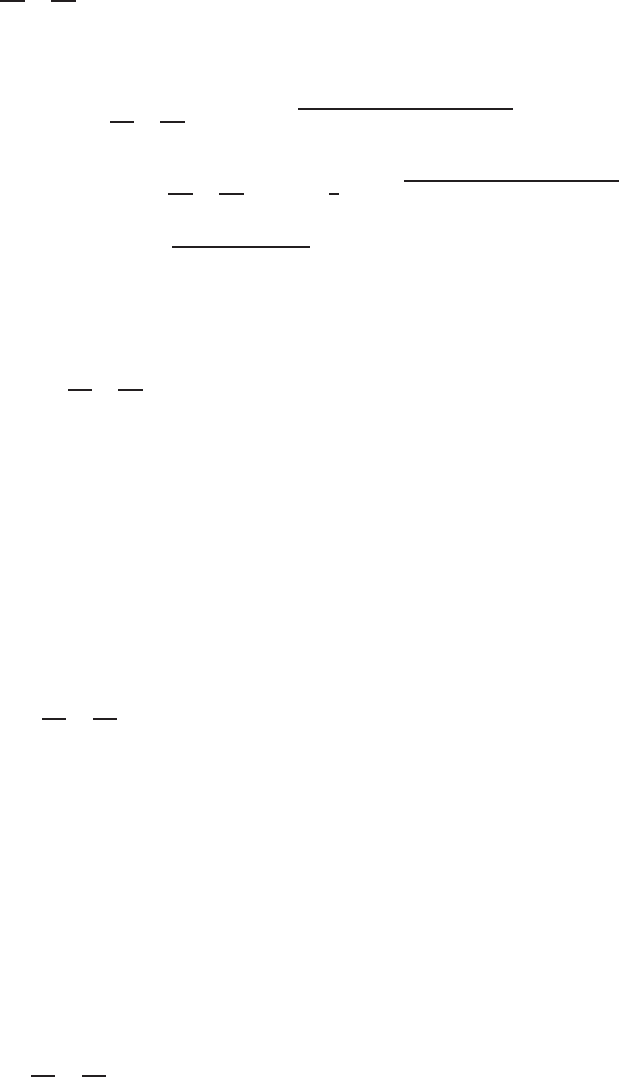
1862 Chapter Twenty-One /SOLUTIONS
Thus
∂~r
∂u ×∂~r
∂v =
~
i~
j~
k
−(1−v) sin u(1 −v) cos u0
a−cos u b −sin u c
=c(1−v) cos u
~
i+c(1 −v) sin u~
j+ (1 −v)(1 −acos u−bsin u)~
k
so
∂~r
∂u ×∂~r
∂v
= (1 −v)pc2+ (1 −acos u−bsin u)2.
Thus
Surface area =Z2π
0Z1
0
∂~r
∂u ×∂~r
∂v
du dv =1
2Z2π
0pc2+ (1 −acos u−bsin u)2du.
This is an elliptic integral that can not be evaluated in terms of elementary functions.
(c) We have Surface Area = (1/2) R2π
0p1 + (1 −2 cos u)2du = 5.805.
17. If Sis the part of the graph of z=f(x, y)lying over a region Rin the xy-plane, then Sis parameterized by
~r (x, y) = x
~
i+y~
j+f(x, y)~
k , (x, y)in R.
So ∂~r
∂x ×∂~r
∂y = (
~
i+fx~
k)×(~
j+fy~
k) = −fx
~
i−fy~
j+~
k .
Since the ~
kcomponent is positive, this points upward, so if Sis oriented upward
d~
A= (−fx
~
i−fy~
j+~
k)dx dy
and therefore we have the expression for the flux integral obtained on page 1018:
ZS
~
F·d~
A=ZR
~
F(x, y, f (x, y)) ·(−fx
~
i−fy~
k+~
k)dx dy.
18. If Sis the part of the cylinder of radius Rcorresponding to the region Tin θz-space, then Sis parameterized in cylindrical
coordinates by
~r (θ, z) = Rcos θ
~
i+Rsin θ~
j+z~
k , (θ, z)in T .
So ∂~r
∂θ ×∂~r
∂z = (−Rsin θ
~
i+Rcos θ~
j)×~
k=Rcos θ
~
i+Rsin θ~
j .
This points outward, so
d~
A= (Rcos θ
~
i+Rsin θ~
j)dθ dz = (cos θ
~
i+ sin θ~
j)R dθ dz
and therefore we obtain the expression for the flux integral in cylindrical coordinates on page 1019:
ZS
~
F·d~
A=ZT
~
F(Rcos θ, R sin θ, z)·(cos θ
~
i+ sin θ~
j)R dθ dz.
19. If Sis the part of the sphere of radius Rcorresponding to the region Tin θφ-space, then Sis parameterized in spherical
coordinates by
~r (θ, φ) = Rsin φcos θ
~
i+Rsin φsin θ~
j+Rcos φ~
k , (θ, φ)in T .
So
∂~r
∂θ ×∂~r
∂φ =
~
i~
j~
k
−Rsin φsin θ R sin φcos θ0
Rcos φcos θ R cos φsin θ−Rsin φ
=−R2sin2φcos θ
~
i−R2sin2φsin θ~
j−R2sin φcos φ~
k
=−R2sin φ(sin φcos θ
~
i+ sin φsin θ~
j+ cos φ~
k).
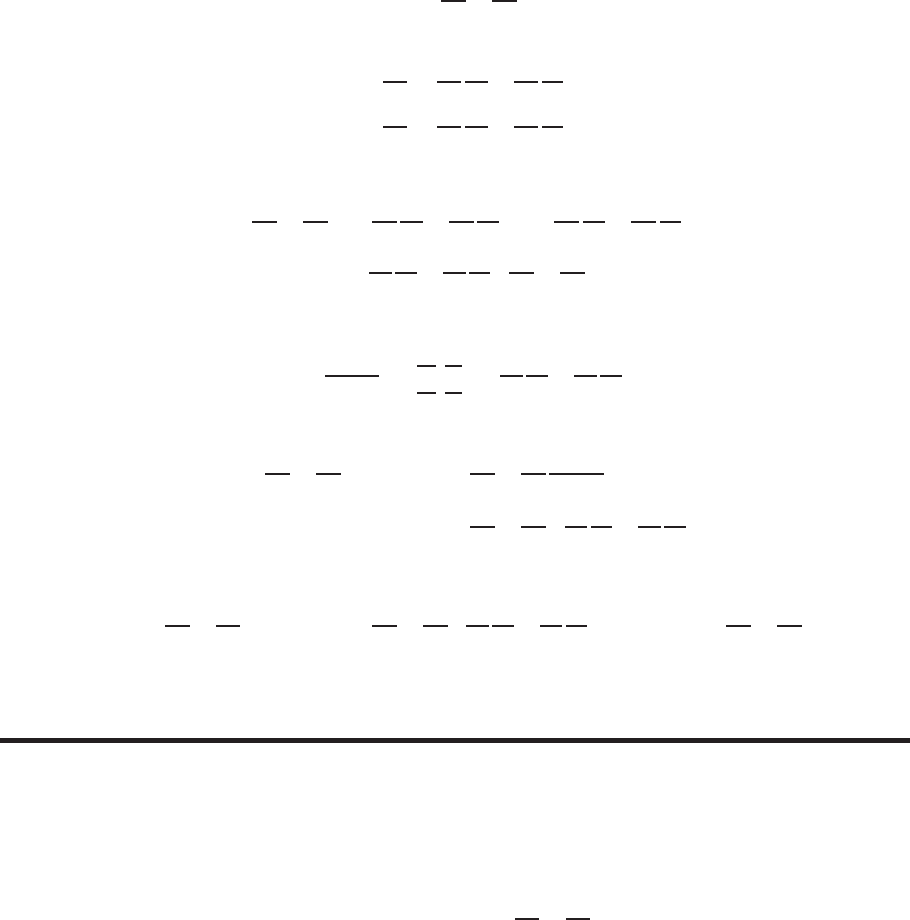
21.3 SOLUTIONS 1863
This points inward, so the outward area element is
d~
A= (sin φcos θ
~
i+ sin φsin θ~
j+ cos φ~
k)R2sin φ dθ dφ,
and therefore we obtain the expression for the flux integral in spherical coordinates on page 1020:
ZS
~
F·d~
A
=ZT
~
F(Rsin φcos θ, R sin φsin θ, R cos φ)·(sin φcos θ
~
i+ sin φsin θ~
j+ cos φ~
k)R2sin φ dθ dφ.
20. In terms of the st-parameterization,
d~
A=∂~r
∂s ×∂~r
∂t ds dt.
By the chain rule, we have
∂~r
∂s =∂~r
∂u
∂u
∂s +∂~r
∂v
∂v
∂s
∂~r
∂t =∂~r
∂u
∂u
∂t +∂~r
∂v
∂v
∂t .
So taking the cross product, we get
∂~r
∂s ×∂~r
∂t =∂~r
∂u
∂u
∂s +∂~r
∂v
∂v
∂s ×∂~r
∂u
∂u
∂t +∂~r
∂v
∂v
∂t
=∂u
∂s
∂v
∂t −∂u
∂t
∂v
∂s ∂~r
∂u ×∂~r
∂v .
Now suppose we are going to change coordinates in a double integral from uv-coordinates to st-coordinates. The
Jacobian is
∂(u, v)
∂(s, t)=
∂u
∂s
∂v
∂s
∂u
∂t
∂v
∂t
=∂u
∂s
∂v
∂t −∂u
∂t
∂v
∂s .
Since the Jacobian is assumed to be positive, converting from a uv-integral to an st-integral gives:
ZT
~
F·∂~r
∂u ×∂~r
∂v dudv =ZR
~
F·∂~r
∂u ×∂~r
∂v
∂(u, v)
∂(s, t)dsdt
=ZR
~
F·∂~r
∂u ×∂~r
∂v ∂u
∂s
∂v
∂t −∂u
∂t
∂v
∂s dsdt.
However, we know that this gives us
ZT
~
F·∂~r
∂u ×∂~r
∂v du dv =ZR
~
F·∂~r
∂u ×∂~r
∂v ∂u
∂s
∂v
∂t −∂u
∂t
∂v
∂s dsdt =ZR
~
F·∂~r
∂s ×∂~r
∂t dsdt.
Thus, the flux integral in uv-coordinates equals the flux integral in st-coordinates.
Strengthen Your Understanding
21. The integral R1
0R1
0f(s, t)ds dt gives the volume of the region between the square 0≤x≤1,0≤y≤1in the xy-plane
and the surface z=f(x, y).
22. The area of the region Rgiven by 0≤s≤2,0≤t≤3in st-space is R3
0R2
0ds dt = 6, but the area of the parameterized
surface Sin xyz-space depends on its parameterization.
The surface Sis parameterized by ~r =f(s, t)
~
i+g(s, t)~
j+h(s, t)~
k. The surface area of Sis given by
Area =ZS
dA=Z3
0Z2
0
∂~r
∂s ×∂~r
∂t ds dt.
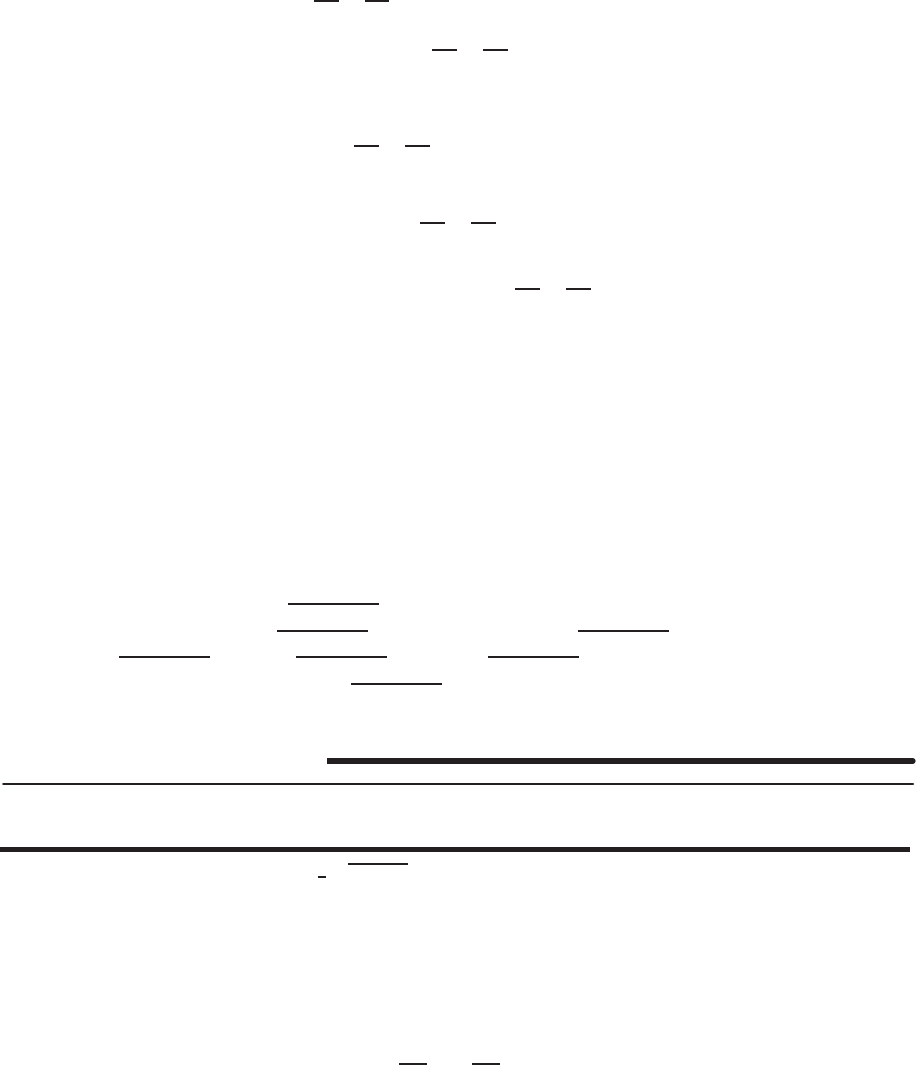
1864 Chapter Twenty-One /SOLUTIONS
23. The region 0≤s≤1,0≤t≤1in the parameter space must correspond to surface area R1
0R1
02ds dt = 2 on the
xy-plane being parameterized. This suggests a parameterization that is a scaling of the usual xy coordinates.
Let x= 2s,y=t,z= 0 so that the parameterization is
~r (s, t) = 2s
~
i+t~
j .
We have
∂~r
∂s ×∂~r
∂t = 2
~
i×~
j= 2~
k
dA =
∂~r
∂s ×∂~r
∂t ds dt = 2ds dt.
24. Since ~r = (s−t)
~
i+t2~
j+ (s+t)~
kwe have
∂~r
∂s ×∂~r
∂t =−2t
~
i−2~
j+ 2t~
k .
Therefore, if ~
F(x, y, z) = −~
j, we have
~
F·∂~r
∂s ×∂~r
∂t = 2 >0
so ZS
~
F·d~
A=Z1
0Z1
0
~
F(~r (s, t)) ·∂~r
∂s ×∂~r
∂t ds dt = 2 >0.
25. True. At every point on Sthe vector field ~
Fis perpendicular to the area vector d~
A .
26. True. The vector 2
~
i−4~
j+ 6~
kis the gradient vector for f(x, y, z) = x2−y2+z2at (1,2,3) so it is perpendicular to
the surface. Thus it is parallel to the area vector.
27. False. It is true that both d~
Aand 3
~
i+ 4~
j+ 5~
kare perpendicular to the plane at every point, so they are multiples of each
other. However, the ratio between them might not be a constant. For example, x=s3,y=t3,z= (1/5)(7 −3s3−4t3)
is a parameterization of the plane, but
d~
A= (3s2
~
i−(9/5)s2~
k)×(3t2~
j−(12/5)t2~
k)dsdt
= ((27/5)s2t2
~
i+ (36/5)s2t2~
j+ 9s2t2~
k)dsdt
= (9/5)s2t2(3
~
i+ 4~
j+ 5~
k)dsdt.
28. Since the half sphere is x=−p1−y2−z2, we parameterize in the form x=x(y, z). Thus, the answer is either (e)
or (f). We have ∂~r /∂y = (y/p1−y2−z2)
~
i+~
jand ∂~r /∂z = (z/p1−y2−z2)
~
i+~
k, and ∂~r /∂y ×∂~r /∂z =
~
i−(y/p1−y2−z2)~
j−(z/p1−y2−z2)~
k=−~r /p1−y2−z2. Our surface is oriented away from the origin,
so we want (∂~r /∂z)×(∂~r /∂y) = ~r /p1−y2−z2, so the answer is (f).
Solutions for Chapter 21 Review
Exercises
1. Since x2+y2= 4z2, we have z=1
2px2+y2. Thus we have a cone of height 7 and maximum radius 14, centered
around the z-axis.
2. This is a parabolic cylinder y=x2, between x=−5and x= 5, with its axis along the z-axis, stretching from z= 0 to
z= 7.
3. The disc Sis defined by the inequality
s2+t2=a2x2+b2y2≤1
that corresponds to the inequality x2+y2≤152or equivalently
1
152x2+1
152y2≤1
that defines R. Thus a2= 1/152and b2= 1/152. We have a= 1/15,b= 1/15.
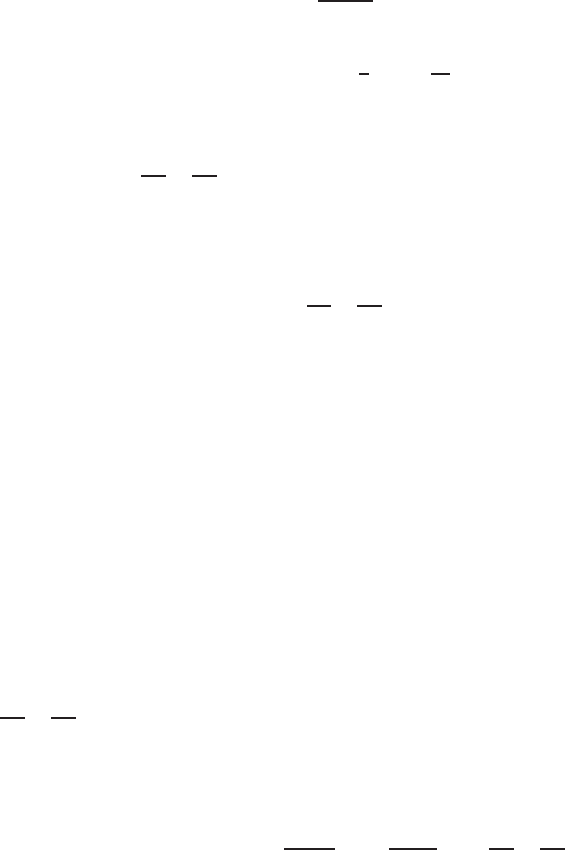
SOLUTIONS to Review Problems for Chapter Twenty-One 1865
4. The disc Sis defined by the inequality
s2+t2=a2x2+b2y2≤1
that corresponds to the inequality x2/4 + y2/9≤1that defines R. Thus a2= 1/4and b2= 1/9. We have a= 1/2,
b= 1/3.
5. Inverting the change of coordinates gives x=s−at,y=t.
The four edges of Rare
y= 15, y = 35, y = 2(x−10) + 15, y = 2(x−30) + 15.
The change of coordinates transforms the edges to
t= 15, t = 35, t = 2s−2at −5, t = 2s−2at −45.
These are equations for the edges of a rectangle in the st-plane if the last two are of the form: s= (Constant). This
happens when the tterms drop out, or a=−1/2. With a=−1/2the change of coordinates gives
Z ZT
∂(x, y)
∂(s, t)ds dt
over the rectangle
T: 15 ≤t≤35,5
2≤s≤45
2.
6. The cross product ∂~r /∂s ×∂~r /∂t is given by
∂~r
∂s ×∂~r
∂t =
~
i~
j~
k
2s20
0 2t5
= 10
~
i−10s~
j+ 4st~
k .
Since the z-component, 4st, of the vector ∂~r /∂s ×∂~r /∂t is positive for 0< s ≤1,1≤t≤3, we see that ∂~r /∂s ×
∂~r /∂t points upward, in the direction of the orientation of Swe were given. Thus, we use
d~
A=∂~r
∂s ×∂~r
∂t ds dt,
and so we have
ZS
~
F·d~
A=Z1
0Z3
1
(5t
~
i+s2~
j)·(10
~
i−10s~
j+ 4st~
k)dt ds
=Z1
0Z3
1
(50t−10s3)dt ds =Z1
0
(25t2−10s3t)
t=3
t=1
ds
=Z1
0
(200 −20s3)ds = (200s−5s4)
1
0
= 200 −5 = 195.
7. Since
~r (a, θ) = acos θ
~
i+asin θ~
j+ sin a2~
k ,
we have
∂~r
∂a ×∂~r
∂θ =
~
i~
j~
k
cos θsin θ2acos a2
−asin θ a cos θ0
=−2a2cos θcos a2~
i−2a2sin θcos a2~
j+a~
k .
The z-component, a, of the vector ∂~r /∂a ×∂~r /∂θ is positive for 1≤a≤3,0≤θ≤π, so ∂~r /∂a ×∂~r /∂θ points
upward, in the direction of the orientation of Swe were given. Thus, we use d~
A= (∂~r /∂a ×∂~r /∂θ)da dθ, giving
ZS
~
F·d~
A=Z3
1Zπ
0(−2
acos θ)~
i+ ( 2
asin θ)~
j·∂~r
∂a ×∂~r
∂θ dθ da
=Z3
1Zπ
0
(4acos a2−4acos a2)dθ da = 0.
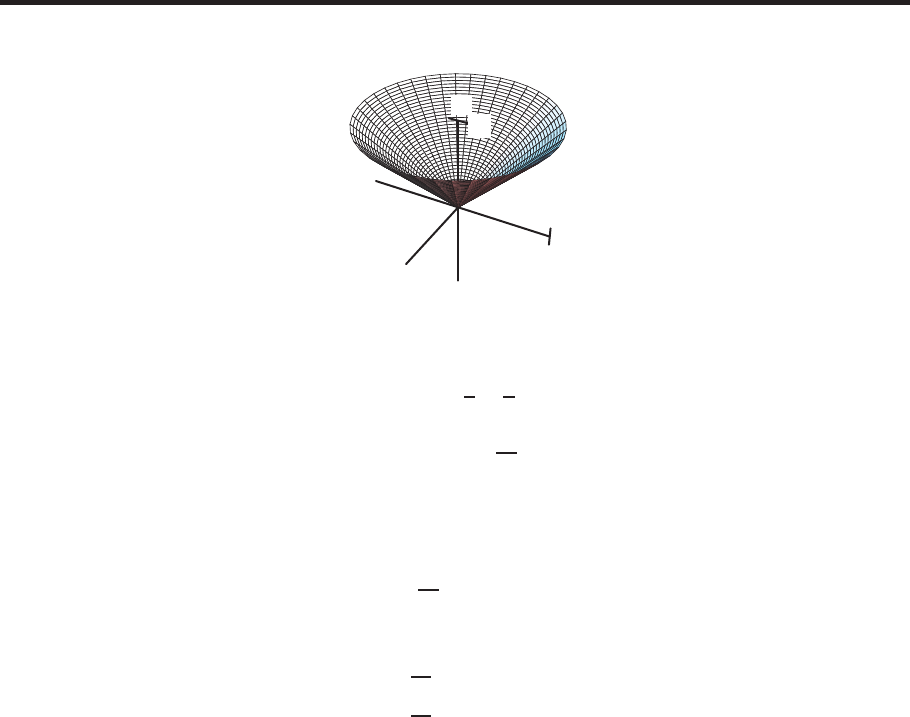
1866 Chapter Twenty-One /SOLUTIONS
8. Two vectors in the plane containing P= (5,5,5),Q= (10,−10,10), and R= (0,20,40) are the displacement vectors
~v 1=~
P Q = 5
~
i−15~
j+ 5~
k
~v 2=~
P R =−5
~
i+ 15~
j+ 35~
k .
Letting ~r 0= 5
~
i+ 5~
j+ 5~
kwe have the parameterization
~r (s, t) = ~r 0+s~v 1+t~v 2
= (5 + 5s−5t)
~
i+ (5 −15s+ 15t)~
j+ (5 + 5s+ 35t)~
k .
9. We use spherical coordinates φand θas the two parameters. The parameterization of the sphere center at the origin and
radius 5 is:
x= 5 sin φcos θ, y = 5 sin φsin θ, z = 5 cos φ.
We have to shift the center of the sphere from the origin to the point (2,−1,3). This gives
x= 2 + 5 sin φcos θ, y =−1 + 5 sin φsin θ, z = 3 + 5 cos φ.
Problems
10. (a) The cone of height h, maximum radius a, vertex at the origin and opening upward is shown in Figure 21.11.
y
x
z
h
a
Figure 21.11
By similar triangles, we have r
z=a
h,
so
z=hr
a.
Therefore, one parameterization is
x=rcos θ, 0≤r≤a,
y=rsin θ, 0≤θ < 2π,
z=hr
a.
(b) Since r=az/h, we can write the parameterization in part (a) as
x=az
hcos θ, 0≤z≤h,
y=az
hsin θ, 0≤θ < 2π,
z=z.
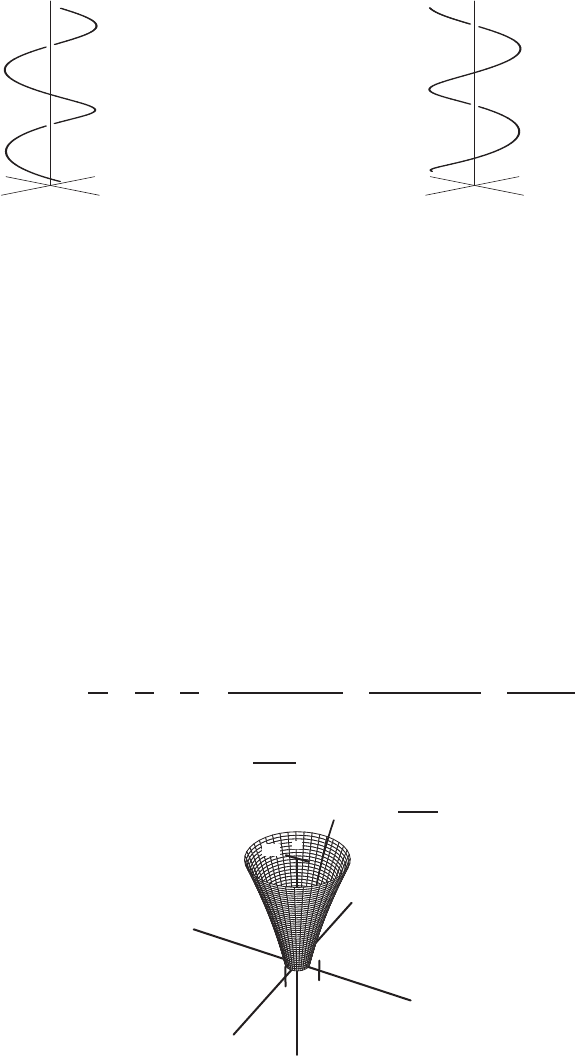
SOLUTIONS to Review Problems for Chapter Twenty-One 1867
11. (a) The surface is the cylinder x2+y2= 1 of radius 1centered on the z-axis.
(b) The parameter curves with constant sand varying tare helices that wind clockwise around the cylinder as they
advance up the cylinder with increasing t. See Figure 21.12.
The parameter curves with constant tand varying sare helices that wind counterclockwise up the cylinder. See
Figure 21.13.
xy
z
Figure 21.12
: Constant s, varying t
xy
z
Figure 21.13
: Constant t, varying s
12. The plane through (1,3,4) and orthogonal to ~n = 2
~
i+~
j−~
kis given by 2(x−1) + (y−3) −(z−4) = 0, that is,
2x+y−z−1 = 0.
Thus, thinking of the plane as z= 2x+y−1, one possible parameterization is
x=u, y =v, z = 2u+v−1.
13. The parameterization for a sphere of radius ausing spherical coordinates is
x=asin φcos θ, y =asin φsin θ, z =acos φ.
Think of the ellipsoid as a sphere whose radius is different along each axis and you get the parameterization:
x=asin φcos θ, 0≤φ≤π,
y=bsin φsin θ, 0≤θ≤2π,
z=ccos φ.
To check this parameterization, substitute into the equation for the ellipsoid:
x2
a2+y2
b2+z2
c2=a2sin2φcos2θ
a2+b2sin2φsin2θ
b2+c2cos2φ
c2
= sin2φ(cos2θ+ sin2θ) + cos2φ= 1.
14. The vase obtained by rotating the curve z= 10√x−1,1≤x≤2, around the z-axis is shown in Figure 21.14.
2
−2x
y
z
10
z= 10√x−1
Figure 21.14

1868 Chapter Twenty-One /SOLUTIONS
At height z, the cross-section is a horizontal circle of radius a. Thus, a point on this horizontal circle is given by
~r =acos θ
~
i+asin θ~
j+z~
k .
However, the radius avaries, so we need to express it in terms of the other parameters θand z. If you look at the xz-plane,
the radius of this circle is given by x, so solving for xin z= 10√x−1gives
a=x=z
10 2
+ 1.
Thus, a parameterization is
~r =z
10 2
+ 1cos θ
~
i+z
10 2
+ 1sin θ~
j+z~
k
so
x=z
10 2
+ 1cos θ, y =z
10 2
+ 1sin θ, z =z,
where 0≤θ≤2π,0≤z≤10.
15. (a) As x2+y2= 9 and s∈[0, π]is equivalent to x≥0, and t∈[0,1] is equivalent to z∈[1,2]. So, x2+y2= 9 is
the equation of a cylinder, and our surface is defined by:
x2+y2= 9, x ≥0,1≤z≤2.
(b) The surface x= 3 sin s,y= 3 cos s,z=t+ 1 for 0≤s≤π,0≤t≤1is shown in Figure 21.15.
x
y
z
Figure 21.15
16.
R
2
4
x
y
Figure 21.16
Given T={(s, t)|0≤s≤2, s ≤t≤2}and
(x=s2
y=t,
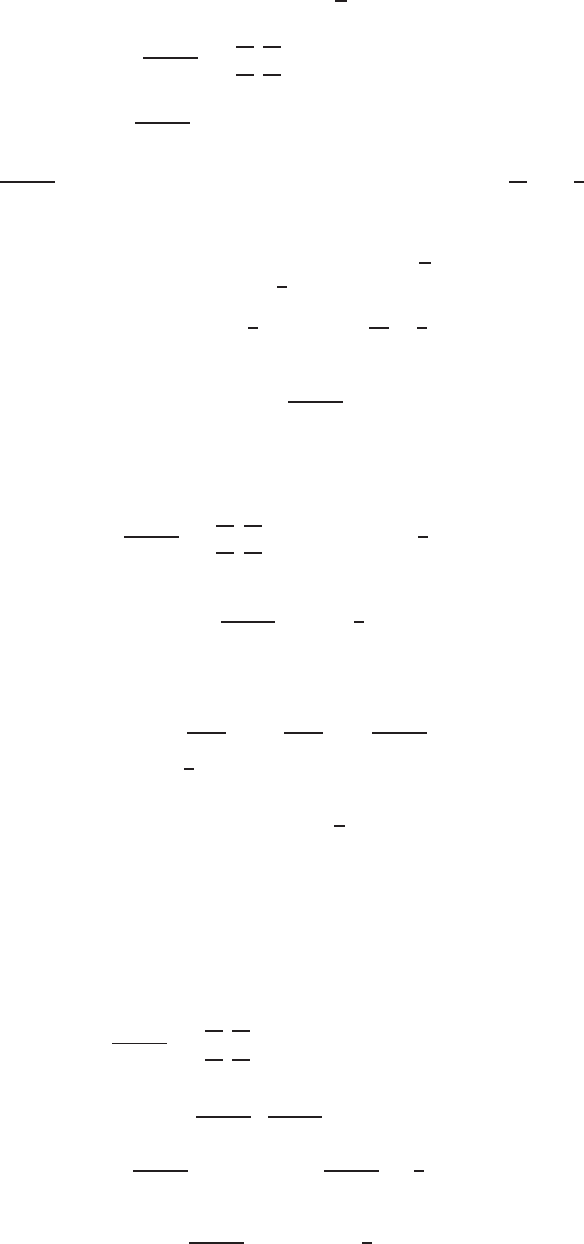
SOLUTIONS to Review Problems for Chapter Twenty-One 1869
R={(x, y)|0≤x≤4,√x≤y≤2}.
∂(x, y)
∂(s, t)=
∂x
∂s
∂x
∂t
∂y
∂s
∂y
∂t
=
2s0
01
= 2s,
∂(x, y)
∂(s, t)= 2ssince 0≤s≤2.
ZT
∂(x, y)
∂(s, t)ds dt = 2 Z2
0
s ds Z2
s
dt = 2 Z2
0
s(2 −s)ds = 2 s2−s3
32
0
=8
3.
So,
ZR
dx dy =Z4
0
dx Z2
√x
dy =Z4
0
(2 −√x)dx
=h2x−2
3x3/2i4
0
=8−16
3=8
3.
Thus ZR
dx dy =ZT
∂(x, y)
∂(s, t)ds dt.
17. We must change coordinates in the area element dA =dx dy, the integrand sin(x+y)and the region R.
Inverting the coordinate change gives x= (s+t)/2,y= (t−s)/2. Thus
∂(x, y)
∂(s, t)=
∂x
∂s
∂x
∂t
∂y
∂s
∂y
∂t
=
1/2 1/2
−1/2 1/2
=1
2.
Therefore
dx dy =
∂(x, y)
∂(s, t)ds dt =1
2ds dt.
The integrand is sin(x+y) = sin t.
The region of integration is
x2+y2=s+t
22
+t−s
22
=s2+t2
2≤1.
Let Tbe the disc s2+t2≤2of radius √2. We have
Z ZR
sin(x+y)dx dy =Z ZT
1
2(sin t)ds dt = 0.
The final integral is zero by symmetry, the integral over the part of the disc where t < 0canceling the integral over the
part where t > 0.
18. Given (s=xy
t=xy2,
we have
∂(s, t)
∂(x, y)=
∂s
∂x
∂s
∂y
∂t
∂x
∂t
∂y
=
y x
y22xy
=xy2=t.
Since ∂(s, t)
∂(x, y)·∂(x, y)
∂(s, t)= 1,
∂(x, y)
∂(s, t)=tso
∂(x, y)
∂(s, t)=1
t
So ZR
xy2dA =ZT
t
∂(x, y)
∂(s, t)ds dt =ZT
t(1
t)ds dt =ZT
ds dt,
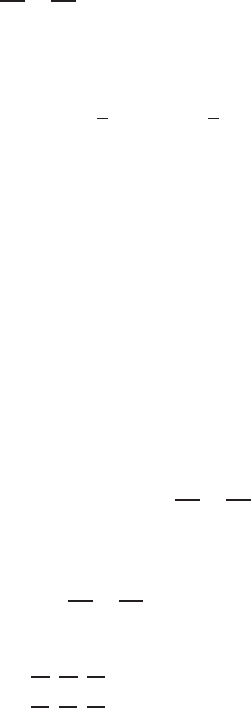
1870 Chapter Twenty-One /SOLUTIONS
where Tis the region bounded by s= 1,s= 4,t= 1,t= 4.
Then ZR
xy2dA =Z4
1
dsZ4
1
dt = 9.
19. The elliptic cylindrical surface is parameterized by
~r =x
~
i+y~
j+z~
k=acos θ
~
i+bsin θ~
j+z~
kwhere 0 ≤θ≤2π, −c≤z≤c.
We have
∂~r
∂θ ×∂~r
∂z =
~
i~
j~
k
−asin θ b cos θ0
0 0 1
=bcos θ
~
i+asin θ~
j .
This vector points away from the z-axis, so we use d~
A= (bcos θ
~
i+asin θ~
j)dθdz, giving
ZS
~
F·d~
A=Zc
−cZ2π
0
(b
a(acos θ)
~
i+a
b(bsin θ~
j)) ·(bcos θ
~
i+asin θ~
j)dθ dz
=Zc
−cZ2π
0
(b2cos2θ+a2sin2θ)dθdz
= 2πc(a2+b2).
20. The surface of Sis parameterized by
~r (θ, φ) = x
~
i+y~
j+z~
k ,
where
x=a+dsin φcos θ,
y=b+dsin φsin θ,
z=c+dcos φ,
for 0≤φ≤π, 0≤θ≤2π.
The vector ∂~r /∂φ ×∂~r /∂θ points outward by the right-hand rule, so
d~
A=∂~r
∂φ ×∂~r
∂θ dφdθ.
Thus,
~
F·d~
A=~
F·∂~r
∂φ ×∂~r
∂θ dφdθ
=
x2y2z2
∂x
∂φ
∂y
∂φ
∂z
∂φ
∂x
∂θ
∂y
∂θ
∂z
∂θ
dφdθ
=
(a+dsin φcos θ)2(b+dsin φsin θ)2(c+dcos φ)2
dcos φcos θ d cos φsin θ−dsin φ
−dsin φsin θ d sin φcos θ0
dφdθ.
Hence,
ZS
~
F·d~
A=d2Z2π
0Zπ
0
(a2sin2φcos θ+ 2ad sin3φcos2θ+d2sin4φcos3θ
+b2sin2φsin θ+ 2bd sin3φsin2θ+d2sin4φsin3θ
+c2sin φcos φ+ 2cd sin φcos2φ+d2sin φcos3φ)dφdθ.
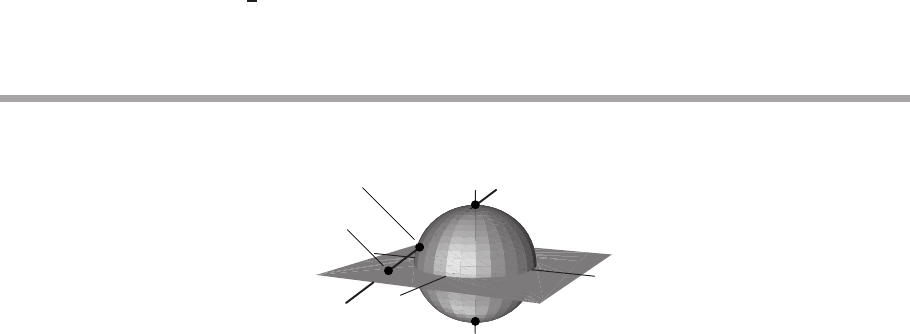
PROJECTS FOR CHAPTER TWENTY-ONE 1871
Since Z2π
0
cos θ dθ =Z2π
0
sin θ dθ =Z2π
0
cos3θ dθ =Z2π
0
sin3θ dθ = 0,
and Zπ
0
sin φcos φ dφ =Zπ
0
sin φcos3φ dφ = 0,
we have
ZS
~
F·~
Ad2Z2π
0Zπ
0
(2ad sin3φcos2θ+ 2bd sin3φsin2θ+ 2cd sin φcos2φ)dφdθ
= 2πd3Zπ
0
(asin3φ+bsin3φ+ 2csin φcos2φ)dφ
= 4πd3Zπ/2
0
(asin3φ+bsin3φ+ 2csin φcos2φ)dφ
=8
3πd3(a+b+c).
PROJECTS FOR CHAPTER TWENTY-ONE
1. The sphere x2+y2+z2= 1 is shown in Figure 21.17.
x
y
z
(x, y, z)
❘
❘
(p, q)
(0,0,1)
(0,0,−1)
Figure 21.17
(a) The origin corresponds to the south pole.
(b) The circle x2+y2= 1 corresponds to the equator.
(c) We get all the points of the sphere by this parameterization except the north pole itself.
(d) x2+y2>1corresponds to the upper hemisphere.
(e) x2+y2<1corresponds to the lower hemisphere.
2. We use the angles θand φshown in the figure in the problem. The angle θis in the xy-plane measured
counterclockwise from the positive x-axis; the angle φis measured perpendicular to the xy-plane.
(a) The circle of radius bin the xy-plane is parameterized by
~r =bcos θ
~
i+bsin θ~
j0≤θ≤2π.
(b) One vector is always ~
k. The other vector is in the same direction as ~r in part (a) but has length 1. Therefore,
we take the other vector to be ~m = cos θ
~
i+ sin θ~
j. Thus, relative to its center, the small circle of radius
acan be parameterized by
~s =acos φ~m +asin φ~
k=acos φ(cos θ
~
i+ sin θ~
j) + asin φ~
k0≤φ≤2π.
(c) The parameterization of the torus with parameters 0≤θ≤2π,0≤φ≤2π, is given by
x
~
i+y~
j+z~
k=~r +~s
= (bcos θ+acos φcos θ)
~
i+ (bsin θ+acos φsin θ)~
j+asin φ~
k .
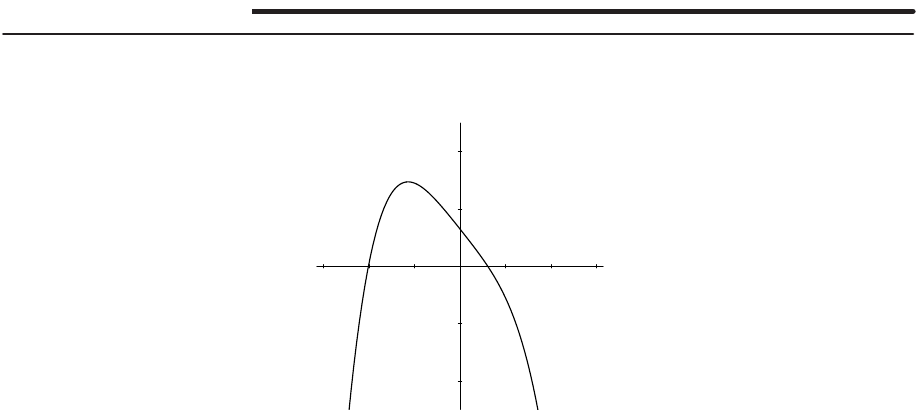
APPENDIX A SOLUTIONS 1873
APPENDIX
Solutions for Section A
1. The graph is
-3 -2 -1 1 2 3
-40
-20
20
40
(a) The range appears to be y≤30.
(b) The function has two zeros.
2. (a) The root is between 0.3 and 0.4, at about 0.35.
(b) The root is between 1.5 and 1.6, at about 1.55.
(c) The root is between −1.8and −1.9, at about −1.85.
3. The root occurs at about −1.05
4. The root is between −1.7and −1.8, at about −1.75.
5. The largest root is at about 2.5.
6. There is one root at x=−1and another at about x= 1.35.
7. There is one real root at about x=−1.1.
8. The root occurs at about 0.9, since the function changes sign between 0.8 and 1.
9. Using a graphing calculator, we see that when x is around 0.45, the graphs intersect.
10. The root occurs between 0.6 and 0.7, at about 0.65.
11. The root occurs between 1.2 and 1.4, at about 1.3.
12. Zoom in on graph: t=±0.824. [Note: tmust be in radians; one must zoom in two or three times.]
13. (a) Only one real zero, at about x=−1.15.
(b) Three real zeros: at x= 1, and at about x= 1.41 and x=−1.41.
14. First, notice that f(3) ≈0.5>0and that f(4) ≈ −0.25 <0.
1st iteration: f(3.5) >0, so a zero is between 3.5 and 4.
2nd iteration: f(3.75) <0, so a zero is between 3.5 and 3.75.
3rd iteration: f(3.625) <0, so a zero is between 3.5 and 3.625.
4th iteration: f(3.588) <0, so a zero is between 3.5 and 3.588.
5th iteration: f(3.545) >0, so a zero is between 3.545 and 3.588.
6th iteration: f(3.578) <0, so a zero is between 3.567 and 3.578.
7th iteration: f(3.572) >0, so a zero is between 3.572 and 3.578.
8th iteration: f(3.575) >0, so a zero is between 3.575 and 3.578.
Thus we know that, rounded to two places, the value of the zero must be 3.58. We know that this is the largest zero
of f(x)since f(x)approaches −1for larger values of x.
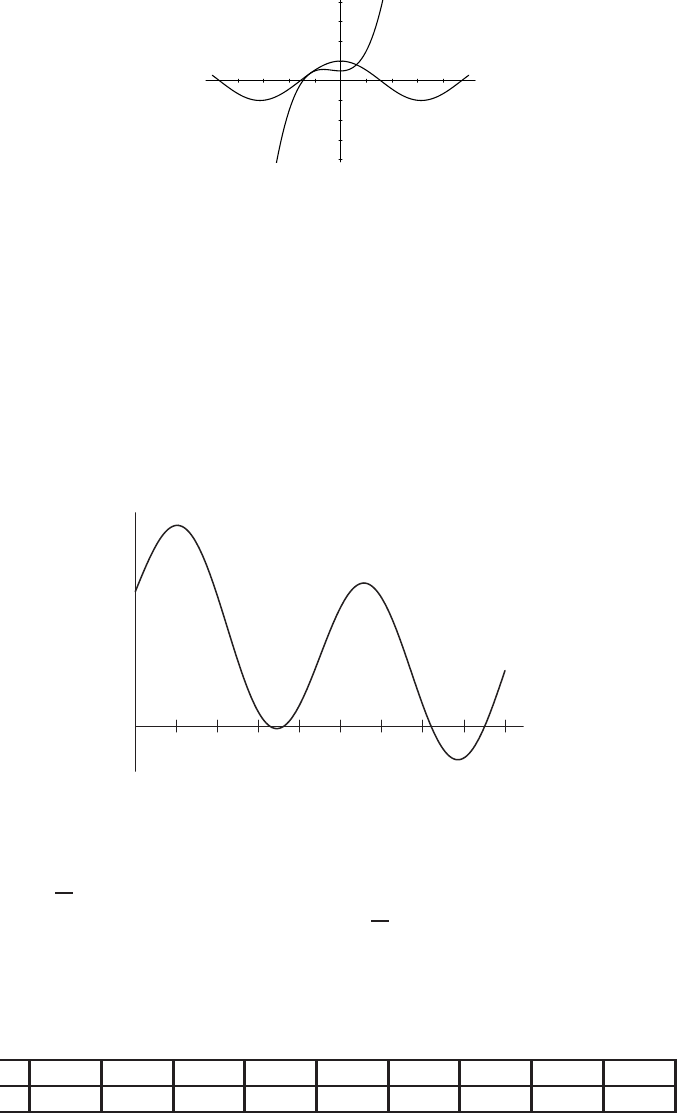
1874 APPENDIX /SOLUTIONS
15. (a) Let F(x) = sin x−2−x. Then F(x) = 0 will have a root where f(x)and g(x)cross. The first positive value of x
for which the functions intersect is x≈0.7.
(b) The functions intersect for x≈0.4.
16. The graph is
-4 -3 -2 -1 1 2 3 4
-8
-6
-4
-2
2
4
6
8
We find one zero at about 0.6. It looks like there might be another one at about −1.2, but zoom in close. . . closer. . . closer,
and you’ll see that though the graphs are very close together, they do not touch, and so there is no zero near −1.2. Thus
the zero at about 0.6is the only one. (How do you know there are no other zeros off the screen?)
17. (a) Since fis continuous, there must be one zero between θ= 1.4and θ= 1.6, and another between θ= 1.6and
θ= 1.8. These are the only clear cases. We might also want to investigate the interval 0.6≤θ≤0.8since f(θ)
takes on values close to zero on at least part of this interval. Now, θ= 0.7is in this interval, and f(0.7) = −0.01 <0,
so fchanges sign twice between θ= 0.6and θ= 0.8and hence has two zeros on this interval (assuming fis not
really wiggly here, which it’s not). There are a total of 4 zeros.
(b) As an example, we find the zero of fbetween θ= 0.6and θ= 0.7.f(0.65) is positive; f(0.66) is negative. So
this zero is contained in [0.65,0.66]. The other zeros are contained in the intervals [0.72,0.73],[1.43,1.44], and
[1.7,1.71].
(c) You’ve found all the zeros. A picture will confirm this; see Figure A.1.
0.2 0.4 0.6 0.8 1 1.2 1.4
1.6
1.8
f(θ) = sin 3θcos 4θ+ 0.8
θ
Figure A.1
18. (a) There appear to be two solutions: one on the interval from 1.13 to 1.14 and one on the interval from 1.08 to 1.09. From
1.13 to 1.14, x3
π3increases from 0.0465 to 0.0478 while (sin 3x)(cos 4x)decreases from 0.0470 to 0.0417, so they
must cross in between. Similarly, going from 1.08 to 1.09, x3
π3increases from 0.0406 to 0.0418 while (sin 3x)(cos 4x)
increases from 0.0376 to 0.0442. Thus the difference between the two changes sign over that interval, so their differ-
ence must be zero somewhere in between.
(b) Reasonable estimates are x= 1.085 and x= 1.131.
19. (a) The first ten results are:
n0 1 2 3 4 5 6 7 8
1 3.14159 5.05050 5.50129 5.56393 5.57186 5.57285 5.57297 5.57299 5.57299
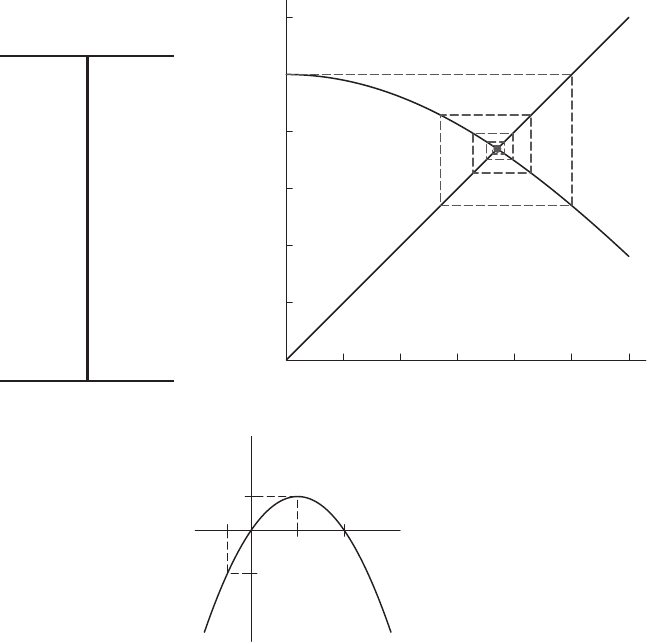
APPENDIX A SOLUTIONS 1875
(b) The solution is x≈5.573. We started with an initial guess of 1, and kept repeating the given procedure until our
values converged to a limit at around 5.573. For each number on the table, the procedure was in essence asking the
question “Does this number equal 4 times the arctangent of itself?” and then correcting the number by repeating the
question for 4 times the arctangent of the number.
(c) P0represents our initial guess of x= 1 (on the line y=x). P1is 4 times the arctangent of 1. If we now use take
this value for P1and slide it horizontally back to the line y=x, we can now use this as a new guess, and call it
P2.P3, of course, represents 4 times the arctangent of P2, and so on. Another way to make sense of this diagram is
to consider the function F(x) = 4 arctan x−x. On the diagram, this difference is represented by the vertical lines
connecting P0and P1,P2and P3and so on. Notice how these lines (and hence the difference between arctan xand
x) get smaller as we approach the intersection point, where F(x) = 0.
(d) For an initial guess of x= 10, the procedure gives a decreasing sequence which converges (more quickly) to the same
value of about 5.573. Graphically, our initial guess of P0will lie to the right of the intersection on the line y=x.
The iteration procedure gives us a sequence of P1,P2, . . . that zigzags to the left, toward the intersection point. For
an initial guess of x=−10, the procedure gives an increasing sequence converging to the other intersection point
of these two curves at x≈ −5.573. Graphically, we get a sequence which is a reflection through the origin of the
sequence we got for an initial guess of x= 10. This is so because both y=xand y= arctan xare odd functions.
20. Starting with x= 0, and repeatedly taking the cosine, we get the numbers below. Continuing until the first three decimal
places remain fixed under iteration, we have this list and diagram:
xcos x
00.735069
10.7401473
0.5403023 0.7356047
0.8575532 0.7414251
0.6542898 0.7375069
0.7934804 0.7401473
0.7013688 0.7383692
0.7639597 0.7395672
0.7221024 0.7387603
0.7504178 0.7393039
0.7314043 0.7389378
0.7442374 etc. 0.2 0.4 0.6 0.8 1 1.2
0.2
0.4
0.6
0.8
1
1.2
x
y
21.
−1
2 4
4
−5
x
f(x) = 4x−x2
Bounded and −5≤f(x)≤4.
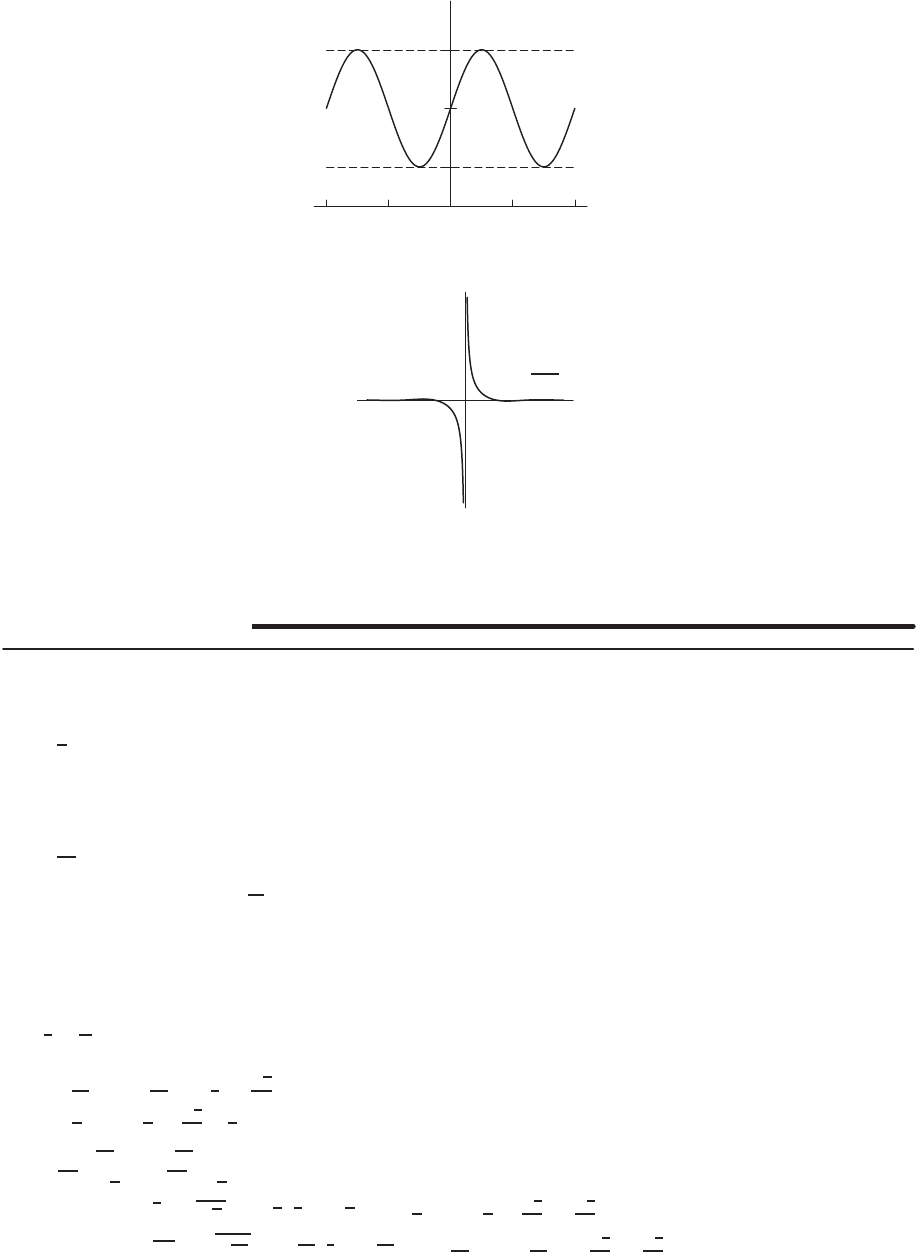
1876 APPENDIX /SOLUTIONS
22.
−2ππ
−π2π
2
5
8
h(θ) = 5 + 3 sin θ
θ
Bounded and 2≤h(θ)≤8.
23.
t
f(t) = sin t
t2
Not bounded because f(t)goes to infinity as tgoes to 0.
Solutions for Section B
1. 2eiπ/2
2. 5eiπ
3. √2eiπ/4
4. 5ei4.069
5. 0eiθ , for any θ.
6. e3πi/2
7. √10eiθ, where θ= arctan(−3) + π= 1.893 is an angle in the second quadrant.
8. 13eiθ , where θ= arctan(−12
5)≈ −1.176 is an angle in the fourth quadrant.
9. −3−4i
10. −11 + 29i
11. −5 + 12i
12. 1 + 3i
13. 1
4−9i
8
14. 3−6i
15. cos 2π
3+isin 2π
3=−1
2+i√3
2
16. cos π
6+isin π
6=√3
2+i
2is one solution.
17. 53(cos 3π
2+isin 3π
2) = −125i
18. 4
√10 cos π
8+i4
√10 sin π
8is one solution.
19. One value of √iis √eiπ
2= (eiπ
2)1
2=eiπ
4= cos π
4+isin π
4=√2
2+i√2
2
20. One value of √−iis pei3π
2= (ei3π
2)1
2=ei3π
4= cos 3π
4+isin 3π
4=−√2
2+i√2
2
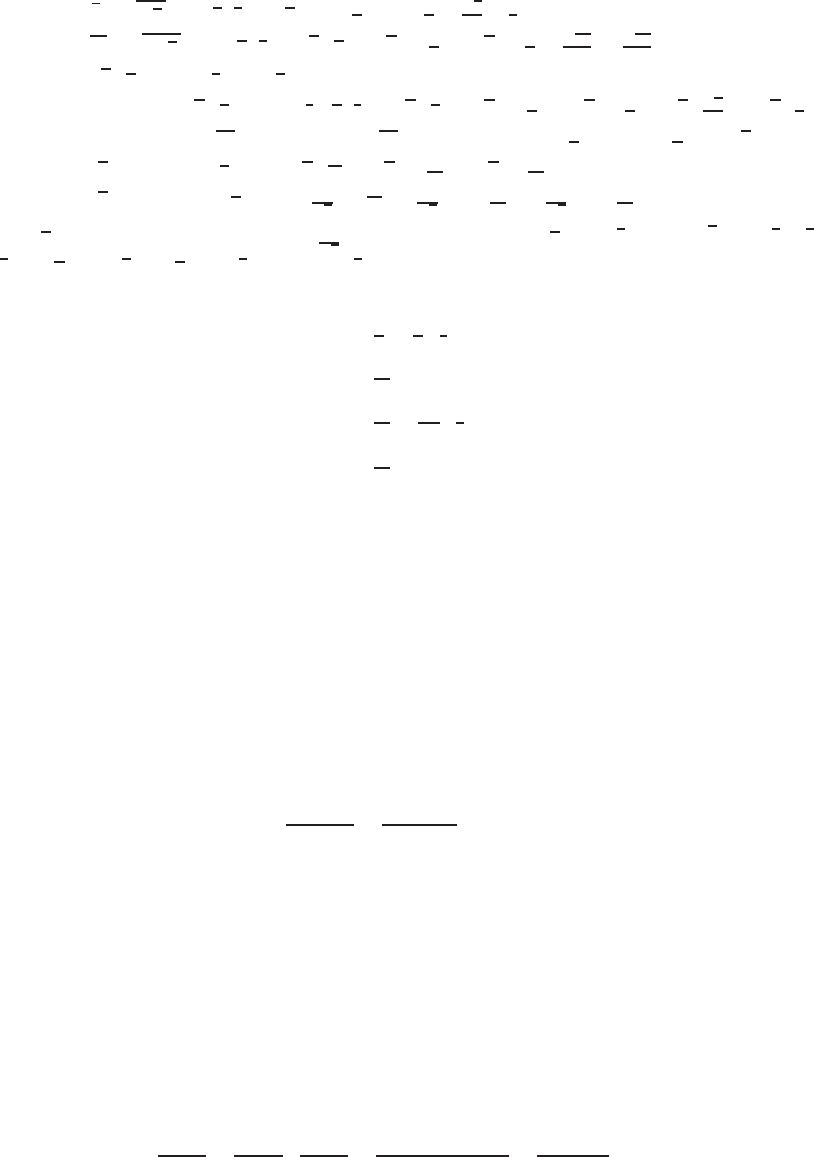
APPENDIX B SOLUTIONS 1877
21. One value of 3
√iis 3
√eiπ
2= (eiπ
2)1
3=eiπ
6= cos π
6+isin π
6=√3
2+i
2
22. One value of √7iis √7eiπ
2= (7eiπ
2)1
2=√7eiπ
4=√7 cos π
4+i√7 sin π
4=√14
2+i√14
2
23. (1 + i)100 = (√2eiπ
4)100 = (2 1
2)100(eiπ
4)100 = 250 ·ei·25π= 250 cos 25π+i250 sin 25π=−250
24. One value of (1 + i)2/3is (√2eiπ
4)2/3= (2 1
2eiπ
4)2
3=3
√2eiπ
6=3
√2 cos π
6+i3
√2 sin π
6=3
√2·√3
2+i3
√2·1
2
25. One value of (−4 + 4i)2/3is [√32e(i3π/4)](2/3) = (√32)2/3e(iπ/2) = 25/3cos π
2+i25/3sin π
2= 2i3
√4
26. One value of (√3 + i)1/2is (2eiπ
6)1/2=√2eiπ
12 =√2 cos π
12 +i√2 sin π
12 ≈1.366 + 0.366i
27. One value of (√3 + i)−1/2is (2eiπ
6)−1/2=1
√2ei(−π
12 )=1
√2cos(−π
12 ) + i1
√2sin(−π
12 )≈0.683 −0.183i
28. Since √5 + 2i= 3eiθ, where θ= arctan 2
√5≈0.730, one value of (√5 + 2i)√2is (3eiθ)√2= 3√2ei√2θ=
3√2cos √2θ+i3√2sin √2θ≈3√2(0.513) + i3√2(0.859) ≈2.426 + 4.062i
29. We have
i−1=1
i=1
i·i
i=−i,
i−2=1
i2=−1,
i−3=1
i3=1
−i·i
i=i,
i−4=1
i4= 1.
The pattern is
in=
−i n =−1,−5,−9,···
−1n=−2,−6,−10,···
i n =−3,−7,−11,···
1n=−4,−8,−12,···.
Since 36 is a multiple of 4, we know i−36 = 1.
Since 41 = 4 ·10 + 1, we know i−41 =−i.
30. Substituting A1= 2 −A2into the second equation gives
(1 −i)(2 −A2) + (1 + i)A2= 0
so
2iA2=−2(1 −i)
A2=−(1 −i)
i=−i(1 −i)
i2=i(1 −i) = 1 + i
Therefore A1= 2 −(1 + i) = 1 −i.
31. Substituting A2= 2 −A1into the second equation gives
(i−1)A1+ (1 + i)(2 −A1) = 0
iA1−A1−A1−iA1+ 2 + 2i= 0
−2A1=−2−2i
A1= 1 + i
Substituting, we have
A2= 2 −A1= 2 −(1 + i) = 1 −i.
32. (a) To divide complex numbers, multiply top and bottom by the conjugate of 1 + 2i, that is, 1−2i:
3−4i
1 + 2i=3−4i
1 + 2i·1−2i
1−2i=3−4i−6i+ 8i2
12+ 22=−5−10i
5=−1−2i.
Thus, a=−1and b=−2.
(b) Multiplying (1 + 2i)(a+bi)should give 3−4i, as the following calculation shows:
(1 + 2i)(a+bi) = (1 + 2i)(−1−2i) = −1−2i−2i−4i2= 3 −4i.
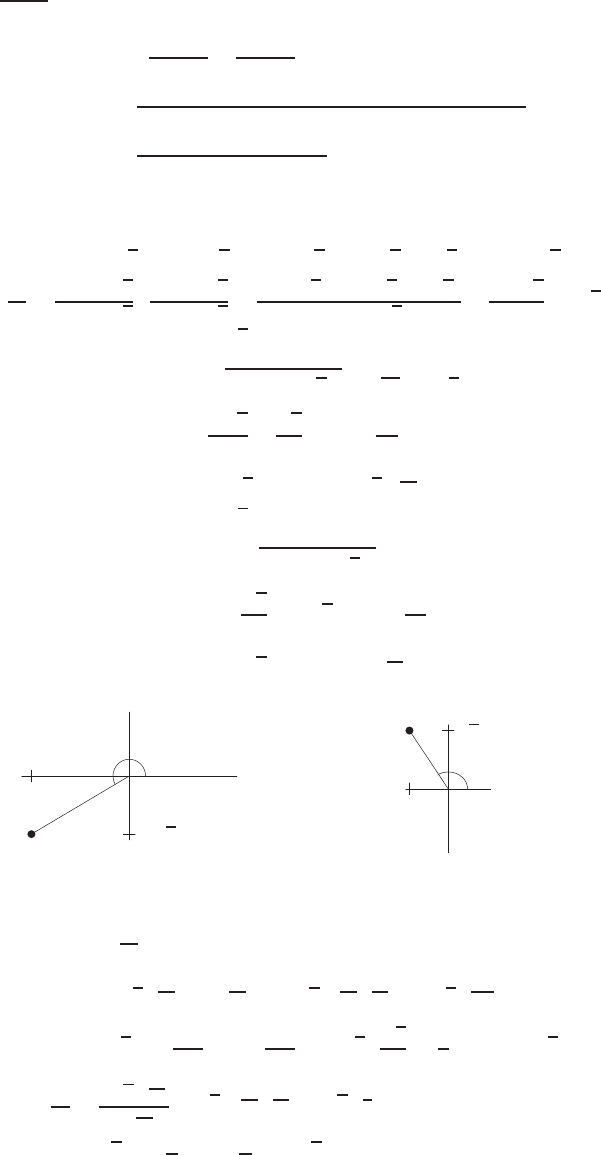
1878 APPENDIX /SOLUTIONS
33. To confirm that z=a+bi
c+di , we calculate the product
z(c+di) = ac +bd
c2+d2=bc −ad
c2+d2i(c+di)
=ac2+bcd −bcd +ad2+ (bc2−acd +acd +bd2)i
c2+d2
=a(c2+d2) + b(c2+d2)i
c2+d2=a+bi.
34. (a)
z1z2= (−3−i√3)(−1 + i√3) = 3 + (√3)2+i(√3−3√3) = 6 −i2√3.
z1
z2
=−3−i√3
−1 + i√3·−1−i√3
−1−i√3=3−(√3)2+i(√3 + 3√3)
(−1)2+ (√3)2=i·4√3
4=i√3.
(b) We find (r1, θ1)corresponding to z1=−3−i√3:
r1=q(−3)2+ (√3)2=√12 = 2√3;
tan θ1=−√3
−3=√3
3, so θ1=7π
6.
(See Figure B.2.) Thus,
−3−i√3 = r1eiθ1= 2√3ei7π
6.
We find (r2, θ2)corresponding to z2=−1 + i√3:
r2=q(−1)2+ (√3)2= 2;
tan θ2=√3
−1=−√3, so θ2=2π
3.
(See Figure B.3.) Thus,
−1 + i√3 = r2eiθ2= 2ei2π
3.
−3
−√3
z1
r1
θ1= 7π/6
◆
Figure B.2
−1
√3
z2
r2θ2= 2π/3
✮
Figure B.3
We now calculate z1z2and z1
z2
.
z1z2=2√3ei7π
62ei2π
3= 4√3ei(7π
6+2π
3)= 4√3ei11π
6
= 4√3hcos 11π
6+isin 11π
6i= 4√3√3
2−i1
2= 6 −i2√3.
z1
z2
=2√3ei7π
6
2ei2π
3
=√3ei(7π
6−2π
3)=√3eiπ
2
=√3cos π
2+isin π
2=i√3.
These agrees with the values found in (a).

APPENDIX B SOLUTIONS 1879
35. First we calculate
z1z2= (a1+b1i)(a2+b2i) = a1a2−b1b2+i(a1b2+a2b1).
Thus, z1z2=a1a2−b1b2−i(a1b2+a2b1).
Since ¯z1=a1−b1iand ¯z2=a2−b2i,
¯z1¯z2= (a1−b1i)(a2−b2i) = a1a2−b1b2−i(a1b2+a2b1).
Thus, z1z2= ¯z1¯z2.
36. If the roots are complex numbers, we must have (2b)2−4c < 0so b2−c < 0. Then the roots are
x=−2b±p(2b)2−4c
2=−b±pb2−c
=−b±p−1(c−b2)
=−b±ipc−b2.
Thus, p=−band q=√c−b2.
37. True, since √ais real for all a≥0.
38. True, since (x−iy)(x+iy) = x2+y2is real.
39. False, since (1 + i)2= 2iis not real.
40. False. Let f(x) = x. Then f(i) = ibut f(¯
i) = ¯
i=−i.
41. True. We can write any nonzero complex number zas reiβ , where rand βare real numbers with r > 0. Since r > 0, we
can write r=ecfor some real number c. Therefore, z=reiβ =eceiβ =ec+iβ =ewwhere w=c+iβ is a complex
number.
42. False, since (1 + 2i)2=−3 + 4i.
43.
1 = e0=ei(θ−θ)=eiθei(−θ)
= (cos θ+isin θ)(cos(−θ) + isin(−θ))
= (cos θ+isin θ)(cos θ−isin θ)
= cos2θ+ sin2θ
44. Using Euler’s formula, we have:
ei(2θ)= cos 2θ+isin 2θ
On the other hand,
ei(2θ)= (eiθ)2= (cos θ+isin θ)2= (cos2θ−sin2θ) + i(2 cos θsin θ)
Equating imaginary parts, we find
sin 2θ= 2 sin θcos θ.
45. Using Euler’s formula, we have:
ei(2θ)= cos 2θ+isin 2θ
On the other hand,
ei(2θ)= (eiθ)2= (cos θ+isin θ)2= (cos2θ−sin2θ) + i(2 cos θsin θ)
Equating real parts, we find
cos 2θ= cos2θ−sin2θ.
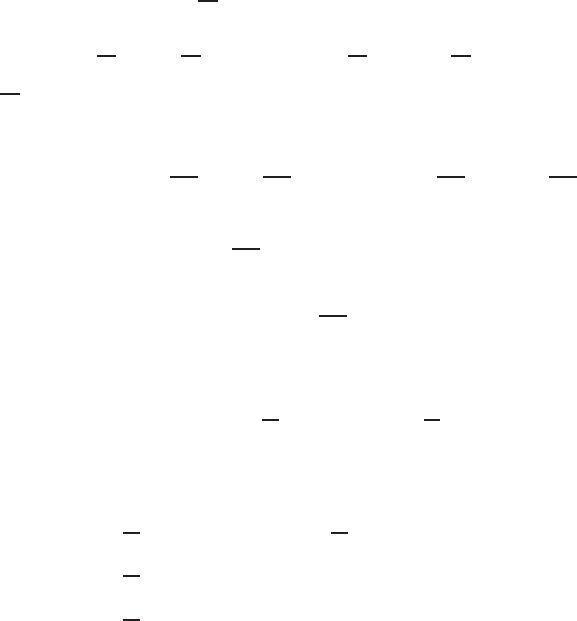
1880 APPENDIX /SOLUTIONS
46. Differentiating Euler’s formula gives
d
dθ (eiθ) = ieiθ =i(cos θ+isin θ) = −sin θ+icos θ
Since in addition d
dθ (eiθ) = d
dθ (cos θ+isin θ) = d
dθ (cos θ) + id
dθ (sin θ), by equating imaginary parts, we conclude
that d
dθ sin θ= cos θ.
47. Differentiating Euler’s formula twice gives
d2
dθ2(eiθ) = d2
dθ2(cos θ+isin θ) = d2
dθ2(cos θ) + id2
dθ2(sin θ).
But
d2
dθ2(eiθ) = i2eiθ =−eiθ =−cos θ−isin θ.
Equating real parts, we find
d2
dθ2(cos θ) = −cos θ.
48. Replacing θby −xin the formula for sin θ:
sin(−x) = 1
2ie−ix −eix=−1
2ieix −e−ix=−sin x.
49. Replacing θby (x+y)in the formula for sin θ:
sin(x+y) = 1
2iei(x+y)−e−i(x+y)=1
2ieixeiy −e−ixe−iy
=1
2i((cos x+isin x) (cos y+isin y)−(cos (−x) + isin (−x)) (cos (−y) + isin (−y)))
=1
2i((cos x+isin x) (cos y+isin y)−(cos x−isin x) (cos y−isin y))
= sin xcos y+ cos xsin y.
50. Since x1,y1,x2,y2are each functions of the variable t, differentiating the sum gives
(z1+z2)′= (x1+iy1+x2+iy2)′= (x1+x2+i(y1+y2))′
= (x1+x2)′+i(y1+y2)′
=x′
1+x′
2+iy′
1+y′
2
= (x1+iy1)′+ (x2+iy2)′
=z′
1+z′
2.
Differentiating the product gives
(z1z2)′= ((x1+iy1) (x2+iy2))′= (x1x2−y1y2+i(y1x2+x1y2))′
= (x1x2−y1y2)′+i(y1x2+x1y2)′
=x′
1x2+x1x′
2−y′
1y2−y1y′
2+iy′
1x2+y1x′
2+x′
1y2+x1y′
2
= [x′
1x2−y′
1y2+i(x′
1y2+y′
1x2)] + [x1x′
2−y1y′
2+i(y1x′
2+x1y′
2)]
=x′
1+iy′
1(x2+iy2) + (x1+iy1)x′
2+iy′
2
=z′
1z2+z1z′
2.
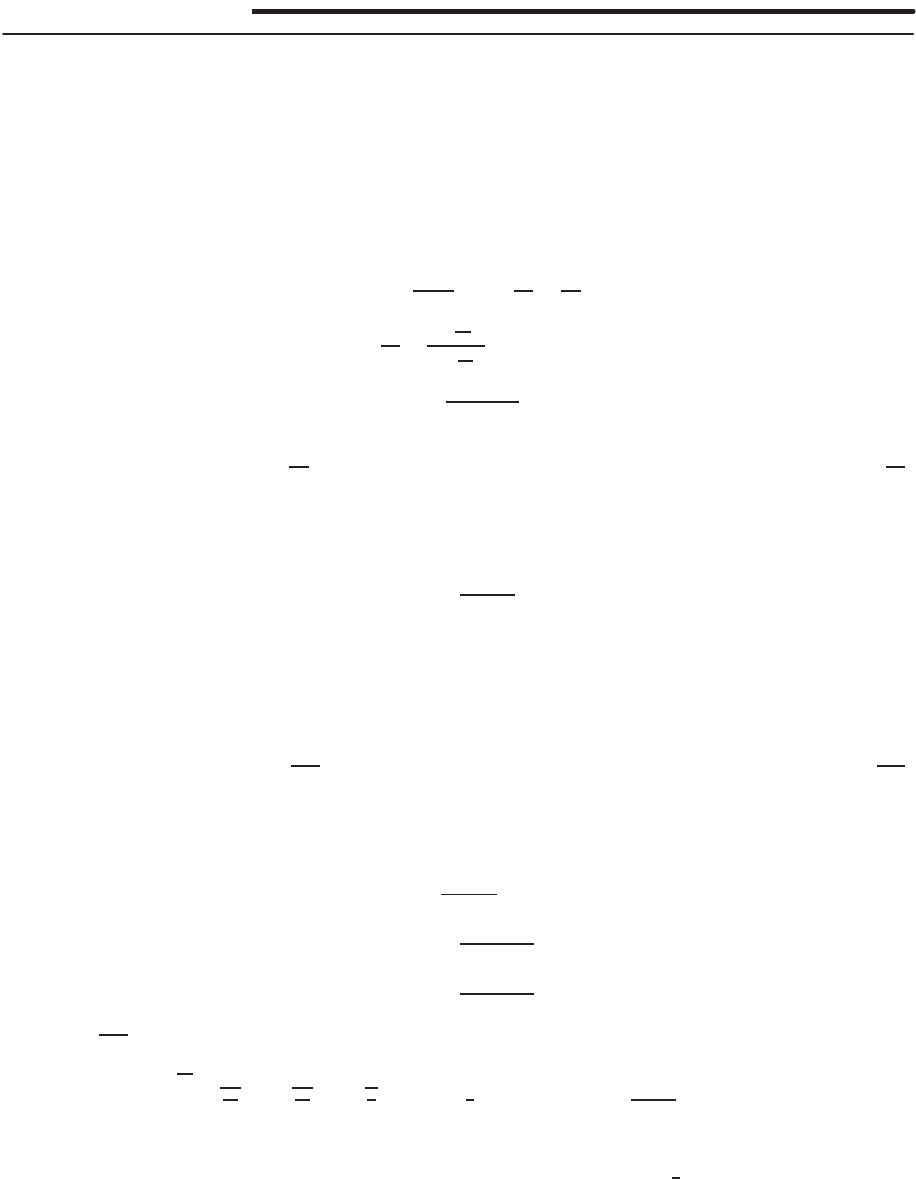
APPENDIX C SOLUTIONS 1881
Solutions for Section C
1. (a) f′(x) = 3x2+ 6x+ 3 = 3(x+ 1)2.Thus f′(x)>0everywhere except at x=−1,so it is increasing everywhere
except perhaps at x=−1. The function is in fact increasing at x=−1since f(x)> f(−1) for x > −1, and
f(x)< f(−1) for x < −1.
(b) The original equation can have at most one root, since it can only pass through the x-axis once if it never decreases.
It must have one root, since f(0) = −6and f(1) = 1.
(c) The root is in the interval [0,1], since f(0) <0< f(1).
(d) Let x0= 1.
x0= 1
x1= 1 −f(1)
f′(1) = 1 −1
12 =11
12 ≈0.917
x2=11
12 −f11
12
f′11
12 ≈0.913
x3= 0.913 −f(0.913)
f′(0.913) ≈0.913.
Since the digits repeat, they should be accurate. Thus x≈0.913.
2. Let f(x) = x3−50. Then f(3
√50) = 0, so we can use Newton’s method to solve f(x) = 0 to obtain x=3
√50.
Since f′(x) = 3x2,f′is always positive, and fis therefore increasing. Consequently, fhas only one zero. Since
33= 27 <50 <64 = 43, let x0= 3.5. Then
x0= 3.5
x1= 3.5−f(3.5)
f′(3.5) ≈3.694
Continuing, we find
x2≈3.684
x3≈3.684.
Since the digits repeat, x3should be correct, as can be confirmed by calculator.
3. Let f(x) = x4−100. Then f(4
√100) = 0, so we can use Newton’s method to solve f(x) = 0 to obtain x=4
√100.
f′(x) = 4x3. Since 34= 81 <100 <256 = 44, try 3.1as an initial guess.
x0= 3.1
x1= 3.1−f(3.1)
f′(3.1) ≈3.164
x2= 3.164 −f(3.164)
f′(3.164) ≈3.162
x3= 3.162 −f(3.162)
f′(3.162) ≈3.162
Thus 4
√100 ≈3.162.
4. Let f(x) = x3−1
10 . Then f(10−1/3) = 0, so we can use Newton’s method to solve f(x) = 0 to obtain x= 10−1/3.
f′(x) = 3x2. Since 3
p1
27 <3
p1
10 <3
p1
8, try x0=1
2. Then x1= 0.5−f(0.5)
f′(0.5) ≈0.467.Continuing, we find
x2≈0.464.x3≈0.464.Since x2≈x3,10−1/3≈0.464.
5. Let f(x) = sin x−1 + x; we want to find all zeros of f, because f(x) = 0 implies sin x= 1 −x.
Graphing sin xand 1−xin Figure C.4, we see that f(x)has one solution at x≈1
2.
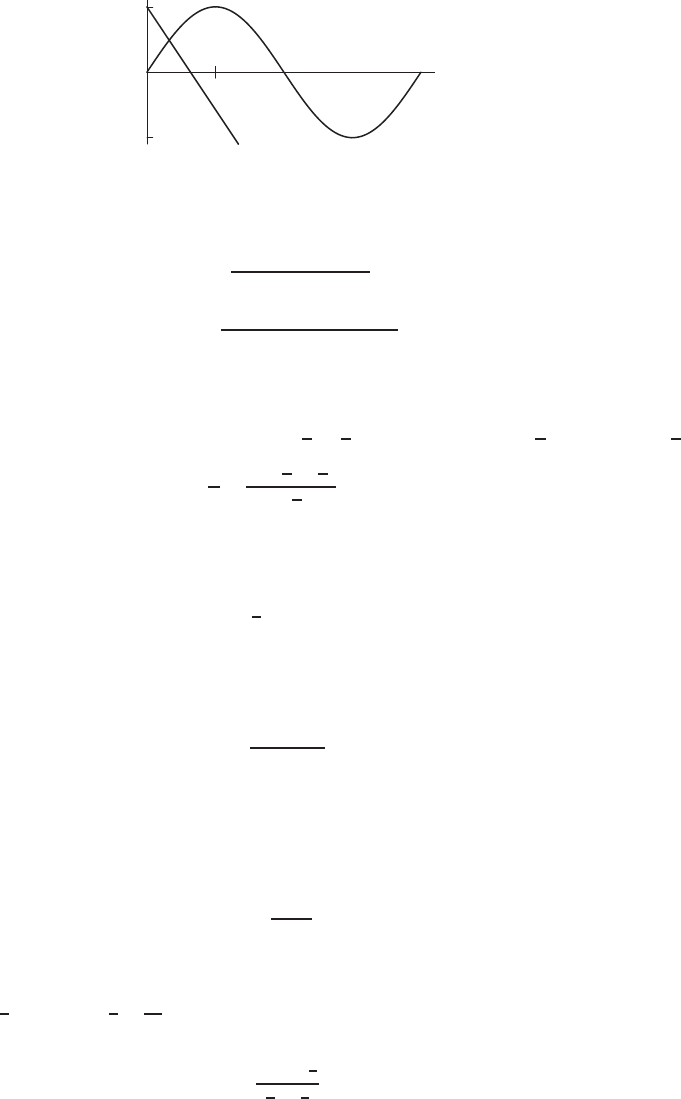
1882 APPENDIX /SOLUTIONS
π/2
−1
1y= sin x
y= 1 −x
Figure C.4
Letting x0= 0.5, and using Newton’s method, we have f′(x) = cos x+ 1, so that
x1= 0.5−sin(0.5) −1 + 0.5
cos(0.5) + 1 ≈0.511,
x2= 0.511 −sin(0.511) −1 + 0.511
cos(0.511) + 1 ≈0.511.
Thus sin x= 1 −xhas one solution at x≈0.511.
6. Let f(x) = cos x−x. We want to find all zeros of f, because f(x) = 0 implies that cos x=x. Since f′(x) = −sin x−1,
f′is always negative (as −sin xnever exceeds 1). This means fis always decreasing and consequently has at most 1
root. We now use Newton’s method. Since cos 0 >0and cos π
2<π
2,cos x=xfor 0< x < π
2. Thus, try x0=π
6.
x1=π
6−cos π
6−π
6
−sin π
6−1≈0.7519,
x2≈0.7391,
x3≈0.7390.
x2≈x3≈0.739.Thus x≈0.739 is the solution.
7. Let f(x) = e−x−ln x. Then f′(x) = −e−x−1
x. We want to find all zeros of f, because f(x) = 0 implies
that e−x= ln x. Since e−xis always decreasing and ln xis always increasing, there must be only 1 solution. Since
e−1>ln 1 = 0, and e−e<ln e= 1, then e−x= ln xfor some x,1< x < e. Try x0= 1.We now use Newton’s
method.
x1= 1 −e−1−0
−e−1−1≈1.2689,
x2≈1.309,
x3≈1.310.
Thus x≈1.310 is the solution.
8. Let f(x) = excos x−1.Then f′(x) = −exsin x+excos x. Now we use Newton’s method, guessing x0= 1 initially.
x1= 1 −f(1)
f′(1) ≈1.5725
Continuing: x2≈1.364,x3≈1.299,x4≈1.293,x5≈1.293. Thus x≈1.293 is a solution. Looking at a graph of
f(x)suffices to convince us that there is only one solution.
9. Let f(x) = ln x−1
x,so f′(x) = 1
x+1
x2.
Now use Newton’s method with an initial guess of x0= 2.
x1= 2 −ln 2 −1
2
1
2+1
4≈1.7425,
x2≈1.763,
x3≈1.763.
Thus x≈1.763 is a solution. Since f′(x)>0for positive x,fis increasing: it must be the only solution.
10. (a) One zero in the interval 0.6< x < 0.7.
(b) Three zeros in the intervals −1.55 < x < −1.45,x= 0,1.45 < x < 1.55.
(c) Two zeros in the intervals 0.1< x < 0.2,3.5< x < 3.6.
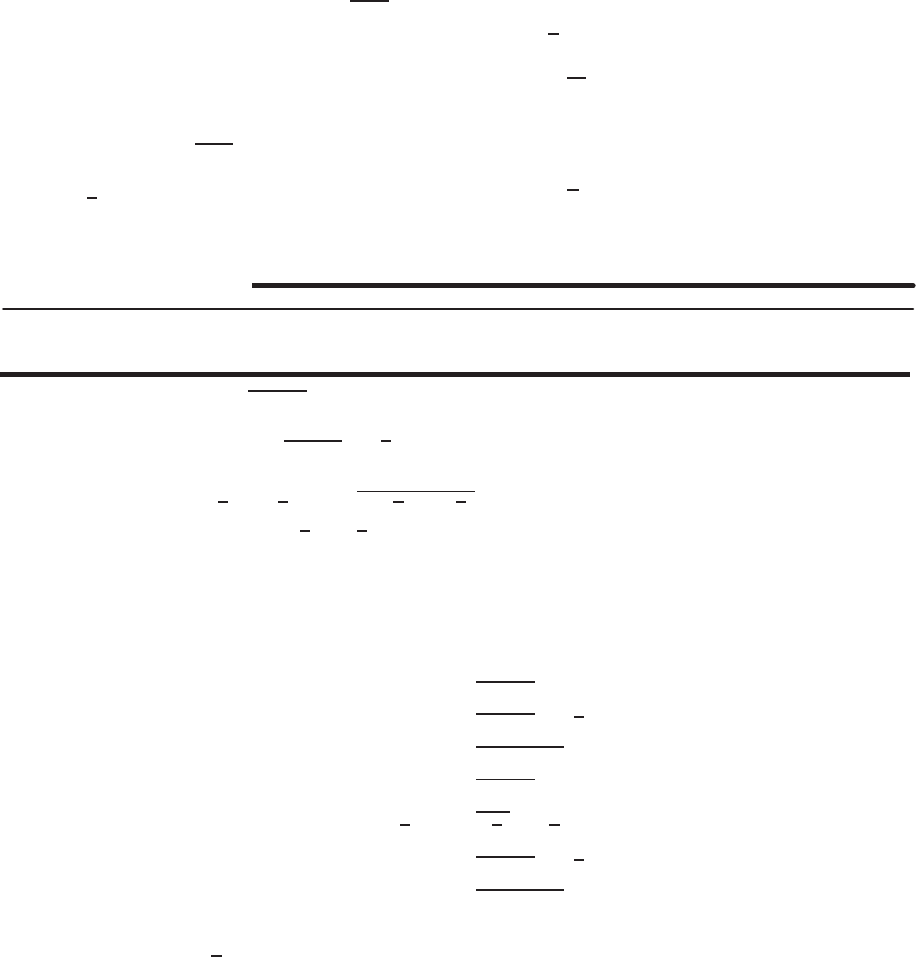
APPENDIX D SOLUTIONS 1883
11. f′(x) = 3x2+ 1. Since f′is always positive, fis everywhere increasing. Thus fhas only one zero. Since f(0) <0<
f(1),0< x0<1. Pick x0= 0.68.
x0= 0.68,
x1= 0.6823278,
x2≈0.6823278.
Thus x≈0.682328 (rounded up) is a root. Since x1≈x2,the digits should be correct.
12. Let f(x) = x2−a, so f′(x) = 2x.
Then by Newton’s method, xn+1 =xn−x2
n−a
2xn
For a= 2 :
x0= 1,x1= 1.5,x2≈1.416,x3≈1.414215,x4≈1.414213 so √2≈1.4142.
For a= 10 :
x0= 5,x1= 3.5,x2≈3.17857,x3≈3.162319,x4≈3.162277 so √10 ≈3.1623.
For a= 1000 :
x0= 500,x1= 251,x2≈127.49203,x3≈67.6678,x4≈41.2229,x5≈32.7406,x6≈31.6418,x7≈31.62278,
x8≈31.62277 so √1000 ≈31.6228.
For a=π:
x0=π
2,x1≈1.7853,x2≈1.7725 x3≈1.77245,x4≈1.77245 so √π≈1.77245.
Solutions for Section D
Exercises
1. The magnitude is k3
~
ik=√32+ 02= 3.
The angle of 3
~
iis 0because the vector lies along the positive x-axis.
2. The magnitude is k2
~
i+~
jk=√22+ 12=√5.
Since 2
~
i+~
jis in the first quadrant, the angle is arctan(1/2) = 0.464 radians, or about 26.6degrees.
3. The magnitude is k − √2~
i+√2~
jk=q(−√2)2+√22= 2.
The direction of the vector −√2~
i+√2~
jis given by the angle θ= 3π/4as the vector bisects the second quadrant.
4. ~v +~w = (1 −2)
~
i+ (2 + 3)~
j= (−1)
~
i+ 5~
j=−~
i+ 5~
j .
5. 2~v +~w = (2 −2)
~
i+ (4 + 3)~
j= 7~
j .
6. ~w + (−2)~u =−2
~
i+ (3 −4)~
j= (−2)
~
i+ (−1)~
j=−2
~
i−~
j .
7. Calculating magnitudes of each vector yields:
k3
~
i+ 4~
jk=p32+ 42= 5
k~
i+~
jk=p12+ 12=√2
k − 5
~
ik=p(−5)2+ 02= 5
k5~
jk=p02+ 52= 5
k√2~
jk=q√22=√2
k2
~
i+ 2~
jk=p22+ 22=√8
k − 6~
jk=p02+ (−6)2= 6.
Thus 3
~
i+ 4~
j , −5
~
iand 5~
jhave the same magnitude.
Also~
i+~
jand √2~
jhave the same magnitude.
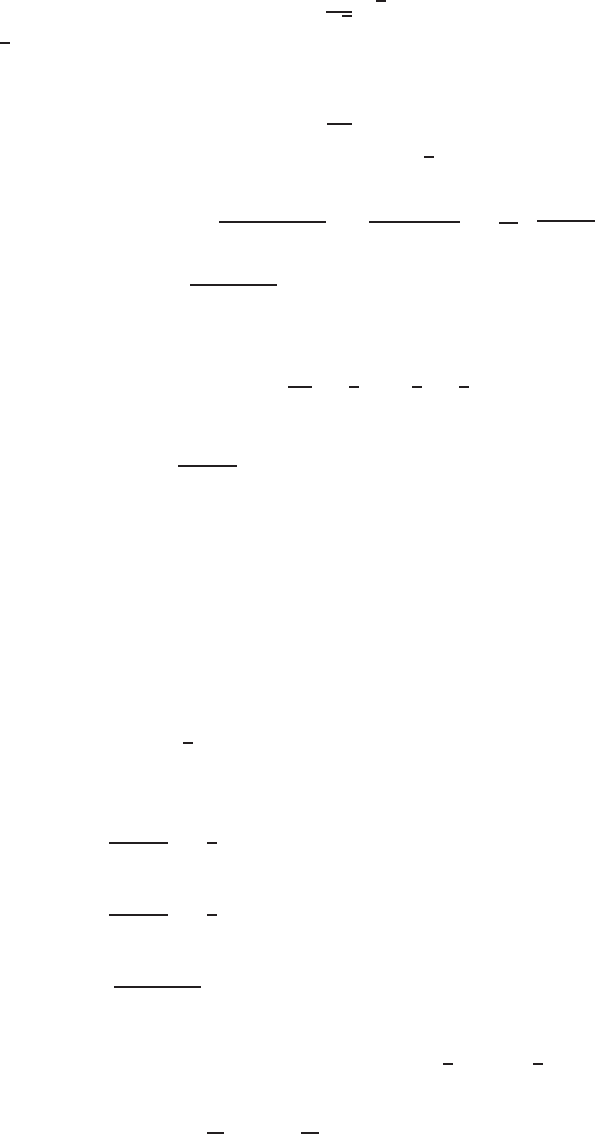
1884 APPENDIX /SOLUTIONS
8. Two vectors are in the same direction if one is a positive scalar multiple of the other.
Since
2(
~
i+~
j) = 2
~
i+ 2~
j
the vectors~
i+~
jand 2
~
i+ 2~
jare in the same direction.
Also
5~
j=5
√2(√2~
j)
so 5~
jand √2~
jare in the same direction.
9. Two vectors have opposite direction if one is a negative scalar multiple of the other. Since
5~
j=−5
6(−6~
j)
the vectors 5~
jand −6~
jhave opposite direction. Similarly, −6~
jand √2~
jhave opposite direction.
10. We work out the left hand side kk~r kand show that it is the same as the right hand side |k|k~r k. We have
kk~r k=kka
~
i+kb~
jk=p(ka)2+ (kb)2=pk2(a2+b2) = √k2pa2+b2=|k|k~r k.
11. (a) The magnitude of −3
~
i+ 4~
jis p(−3)2+ 42= 5, so we want to scale down the magnitude by a factor of 5. Scalar
multiplying by 1/5does not change the vector’s direction, and gives the unit vector (−3/5)
~
i+ (4/5)~
j .
(b) Scalar multiplying by −1reverses a vector’s direction without changing its magnitude. So
(−1) −3
5~
i+4
5~
j=3
5~
i−4
5~
j
is a unit vector in the direction opposite to the original.
12. A vector making an angle of 90◦with the positive x-axis lies along the positive y-axis, so it is of the form ~v =a~
jwith
apositive. Its magnitude is k~v k=√02+a2=a, so a= 5. The vector is 5~
j.
13. Scalar multiplication by 2 doubles the magnitude of a vector without changing its direction. Thus, the vector is 2(4
~
i−
3~
j) = 8
~
i−6~
j.
14. Scalar multiplication by −1reverses the direction of a vector without changing its magnitude. Thus, the vector is
(−1)(4
~
i−3~
j) = −4
~
i+ 3~
j.
15. The vector is (4 −3)
~
i+ (4 −2)~
j=~
i+ 2~
j.
16. In components, the vector from (6,6) to (−6,−6) is ((−6) −6)
~
i+ ((−6) −6)~
j=−12
~
i−12~
j, which is not equal
to 6
~
i−6~
j.
17. In components, the vector from (7,7) to (9,11) is (9 −7)
~
i+ (11 −9)~
j= 2
~
i+ 2~
j.
In components, the vector from (8,10) to (10,12) is (10 −8)
~
i+ (12 −10)~
j= 2
~
i+ 2~
j.
The two vectors are equal.
18. In components, the vector of length √2making an angle of π/4with the positive x-axis is~
i+~
j, which is not the same
as −~
i+~
j.
19. In components, the vector from (1,12) to (6,10) is (6 −1)
~
i+ (10 −12)~
j= 5
~
i−2~
j. The two vectors are equal.
20. The velocity is ~v (t) = 1
~
i+ 2t~
j. When t= 1 the velocity vector is ~v =~
i+ 2~
j .
The speed is k~v k=√12+ 22=√5.
The acceleration is ~a (t) = 2~
j.
21. The velocity is ~v (t) = et
~
i+ (1/(1 + t))~
j . When t= 0,the velocity vector is ~v =~
i+~
j .
The speed is k~v k=√12+ 12=√2.
The acceleration is ~a (t) = et
~
i−1/((1 + t)2)~
j. When t= 0, the acceleration vector is ~a =~
i−~
j.
22. The velocity is ~v (t) = −5 sin t
~
i+ 5 cos t~
j . When t=π/2,the velocity vector is ~v =−5
~
i .
The speed is k~v k=p(−5)2+ 02= 5.
The acceleration is ~a (t) = −5 cos(t)
~
i−5 sin(t)~
j. For t=π/2, the acceleration vector is ~a =−5~
j.
23. The position vector is
~r (π/4) = cos(π/4)
~
i+ sin(π/4)~
j= (1/√2)
~
i+ (1/√2)~
j .
The velocity vector is
~v (t) = d
dt cos t~
i+d
dt sin t~
j=−sin t~
i+ cos t~
j ,
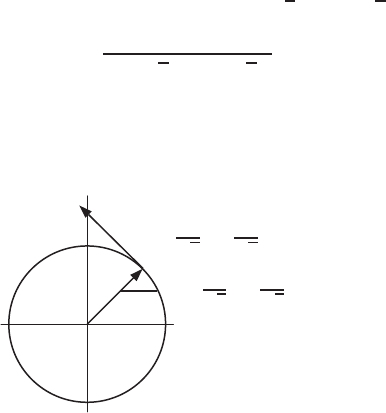
APPENDIX D SOLUTIONS 1885
so
~v (π/4) = −sin(π/4)
~
i+ cos(π/4)~
j= (−1/√2)
~
i+ (1/√2)~
j .
The speed is
||~v || =q(−1/√2)2+ (1/√2)2= 1.
We recognize ~r (t)as the parameterization of a unit circle, centered at the origin. Figure D.5 shows the curve together
with the position and velocity vectors when t=π/4.We see that the velocity vector is tangent to the circle.
x
y
~v =−1
√2
~
i+1
√2
~
j
✛~r =1
√2
~
i+1
√2
~
j
Figure D.5
: Position and velocity vectors
for motion along a circle